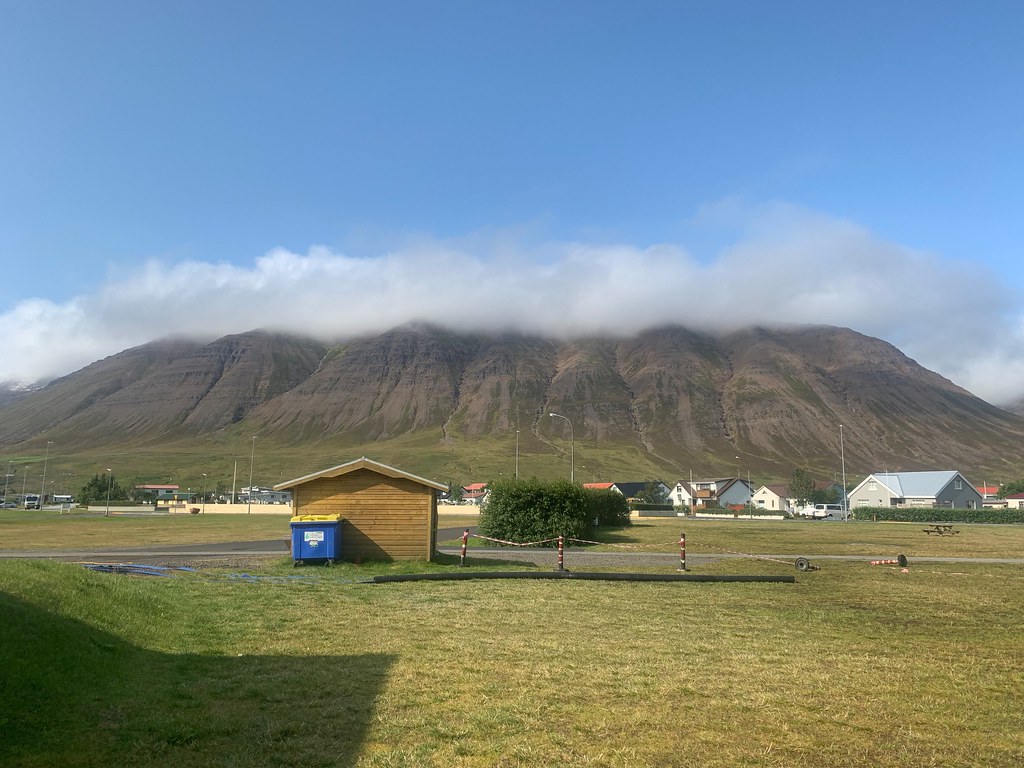As I was packing up for the day’s ride, I looked at the map and realized that Akureyri had a really nice looking botanical garden. It would be a shame to skip that entirely. So I decided I would just get a late start and bicycle into the night.
On the way up to the garden I noticed how big the city is. It’s the fifth largest city in Iceland – with about 20,000 people in it – but it feels bigger than that. Many of the houses were in fine shape and the architectural style felt familiar to me. I wanted to stay for a week and hang out in all the fancy cafés the museums, but alas… No time.
The botanical gardens are at the top of a large hill next to a hospital. No bike racks – typical for any place that isn’t Reykjavík, really – so I just rolled my bike onto the property and parked it next to a garden shed. So many people were walking past it, pointing and commenting and even taking photos, that I knew a thief would feel uncomfortable trying to pick it over. I was growing used to Iceland’s crime-free ways.
Even if I couldn’t hang out in all the cafés, I could at least enjoy the one inside the gardens. Time for something healthy, and something totally unhealthy!
Then I spent the next hour or so walking around snapping photos and taking in the unexpected lushness of so many flowering plants in one place, in the middle of Iceland.
There were also plenty of neat little statues and buildings to explore as well.
There was also a large area near the greenhouses covered with grids of seedlings, each bearing a detailed label. I couldn’t tell if they were for eventual sale, or if they constituted a kind of seed bank for the garden during the long winter months.
I wanted to linger, but I wasn’t sure how much time the big mountain would take, and the day was moving quickly. I hopped on my bike and rode for the highway. Along the way I stopped to refill my water sack at a service station, and there I spotted a new kind of snack for sale:
Almost all the remaining daylight was used slowly climbing the hill to the east of town. There is a tunnel that passes under the hill, as part of Highway 1, but bicycles are not allowed to use it. I could have gone farther north and avoided some of the elevation climb, but I assumed from experience that extra length of that alternate route would be filled with smaller hills that collectively added up to just as much elevation change. At least this way I could get it all over with at once.
I listened to a cute little nonfiction Q&A book called “Why Don’t Penguins’ Feet Freeze”. Most of it was familiar, but I was truly surprised by the section about freezing water. Apparently water that has just been brought to boiling temperature and then placed in a freezer will solidify slightly faster than water placed in the same freezer at room temperature. No one knew – as far as the authors of the book could tell – exactly why this happened. The best theory they had was that the hot water made the container hot, which temporarily unfroze the icy surface that the container was placed on, creating a much bigger contact surface between the container and the rest of the freezer, encouraging faster heat transfer.
Higher and higher I went. I passed some nifty roadsigns along the way.
Pretty soon I could see well into the mountains on the opposite side of the fjord.
I ate some of the dehydrated fish. I could tell the protein content was good, but the flavor was weak, and chewing on it dehydrated my mouth to the point where I had to sip water every time I ate a piece. I finished off the first bag and poured the crumbs into my mouth, which came along with a quantity of fish-dust as well. Then stood I there coughing and wheezing like a pack-a-day smoker for a minute. For all of the next mile, the only thing I could smell was fish.
The sun got low enough for the hills to start casting shadows.
Some guys on motorbikes went zipping up the mountain, slowing down to pass me. I nodded at each in turn. About two hours later I reached the top of the hill and the bikers came back down, slightly dirtier than before.
The top of the hill had a plateau about a kilometer long. The sunset colors were amazing, and as I drifted along I craned my neck to take it all in.
The view from the edge of the plateau was amazing. I knew I had miles to go, but I couldn’t resist stopping for a bunch of photos.
Then the downhill part began. Much lumpier than the other side, with a couple of terrible-looking bridges that looked like they’d been traumatized by large trucks and ice, perhaps simultaneously, for years.
I was applying the brake constantly, keeping my speed to a safe level just in case I hit something weird. Sure enough I came to the bottom of a hill and there was a big washout of sand spread across the road. The bike tipped and I landed on my side.
I fell into the sand, which made a nice cushion. If I’d been going faster it would have been a lot worse because my momentum would have carried me out of the sand as I fell, and I would have landed and slid across hard-packed dirt with gravel on it. Assuming I didn’t bruise anything, the friction would have probably torn through my pants and jacket, rendering them both useless as insulating layers.
Simply being unable to protect myself from the cold wind might have forced me to cut my trip short. Wind protection is that important!
As it was, I just got up, pushed my bike upright, slapped a lot of dirt off … and carried right on with the journey.
By the time I was at the bottom of the hill and back on Highway 1, it was fully dark. I hauled out my phone and considered the options. About a mile south was a campground, but it was in the wrong direction and I would have to retrace my steps in the morning. I hated retracing my steps. I could push ahead to the campground at Fossholl – a tiny roadside installation next to a waterfall – and that would line me up nicely to do the next 30 miles to Lake Mývatn. “That sounds good,” I thought, “and besides I like riding at night.”
I put some spooky short stories on the iPod and got to pedaling. The night time rewarded me, with moonlit skies, shadowy open fields, and for a while I even rode alongside a big lake, only a few meters from the water. I got inspired and narrated a little essay into my phone, on what the experience of bike touring is like. It was quite late when I finally got to the campground at Fossholl but it felt like I’d made a good decision. Night riding plays hell with the schedule for hotels and restaurants and attractions, but it’s so pleasant that it’s worth it sometimes.
{"lat":[65.678165129,65.678165129,65.678165213,65.678165632,65.678165884,65.678166387,65.678166806,65.678167392,65.678167057,65.678166722,65.67816647,65.678166303,65.678165967,65.678165632,65.678165548,65.678165297,65.678165884,65.678165884,65.678166387,65.678166219,65.678166387,65.67816647,65.678166303,65.678166219,65.678165967,65.6781658,65.6781658,65.6781658,65.678166051,65.678166303,65.678166638,65.678166889,65.678167141,65.678167979,65.67816865,65.678168985,65.678169404,65.678170075,65.678170326,65.678170829,65.678170494,65.678170661,65.678170577,65.678170326,65.678170326,65.678170242,65.678170326,65.678170326,65.678170242,65.678170577,65.678170577,65.678170326,65.678170326,65.67817041,65.678170326,65.678170158,65.678170158,65.678169739,65.678169739,65.678170075,65.678170158,65.678170075,65.678170158,65.678170075,65.678169991,65.678169823,65.678169655,65.678169572,65.678169488,65.678169488,65.67816932,65.678169236,65.67816932,65.678169488,65.678169655,65.678169991,65.678169823,65.678169907,65.678170075,65.678170075,65.678170158,65.678170326,65.678170494,65.678169991,65.678170326,65.678170494,65.678170829,65.678171332,65.678171667,65.678171919,65.678172086,65.678172254,65.678172673,65.678172841,65.678173092,65.67817326,65.678173344,65.678173511,65.678173595,65.678173427,65.678173176,65.678173176,65.678173008,65.678172841,65.678172673,65.678172505,65.678172421,65.678172338,65.678172338,65.678172338,65.678172421,65.678172505,65.678172505,65.678172505,65.678172505,65.678172589,65.678172841,65.678173092,65.67817326,65.678173344,65.678173595,65.678173679,65.678173846,65.678173846,65.678173763,65.678173846,65.67817393,65.678174098,65.678174182,65.678174266,65.678174685,65.678175271,65.678175858,65.678176361,65.678176612,65.678176864,65.678177115,65.678177283,65.678177451,65.678177534,65.67817787,65.678178373,65.678179043,65.678179462,65.678179881,65.678180384,65.678180468,65.67818072,65.678180803,65.678180887,65.678180971,65.678180887,65.67818072,65.678180636,65.678180468,65.6781803,65.678180217,65.678181222,65.678181977,65.678181725,65.678181809,65.678182144,65.678181809,65.678181725,65.67818139,65.678181558,65.678181474,65.678181809,65.678181977,65.678182396,65.678182815,65.678183486,65.678183402,65.678183402,65.678183402,65.678183402,65.678183402,65.678183402,65.678183402,65.678183234,65.67818315,65.678182899,65.678182815,65.678182899,65.678182899,65.678183067,65.678182899,65.678182731,65.678182564,65.678182228,65.678182144,65.678181893,65.678181977,65.678182228,65.67818248,65.678182815,65.678183067,65.678183486,65.678183569,65.678183821,65.678184491,65.678184743,65.678184575,65.678184575,65.678184575,65.678184491,65.678184156,65.678184324,65.678184324,65.678184491,65.678184491,65.678184491,65.678184575,65.678184575,65.678184575,65.678184659,65.678184743,65.678184659,65.678184659,65.678184659,65.678184491,65.678184491,65.678184408,65.678184156,65.678183989,65.678183821,65.678183821,65.678183569,65.678183234,65.678182899,65.678182564,65.678182144,65.678181809,65.67818139,65.678180803,65.678180049,65.678179211,65.678178708,65.678178037,65.678177451,65.678177115,65.678176612,65.678176277,65.678176026,65.678175858,65.67817569,65.67817569,65.67817569,65.678175607,65.678175523,65.678175355,65.678175188,65.678174936,65.678174768,65.678174601,65.678174433,65.678174182,65.678173846,65.678173511,65.67817326,65.678172841,65.678172841,65.678172589,65.678172505,65.678172338,65.678172505,65.678172841,65.678173092,65.67817326,65.678173344,65.678173595,65.678173846,65.678174182,65.678174349,65.678174517,65.678174601,65.678174601,65.678174685,65.678174852,65.678175104,65.678175104,65.678174852,65.678174685,65.678174936,65.678174852,65.678174852,65.678174852,65.678174936,65.678174936,65.678175104,65.678175188,65.678175271,65.678175271,65.678175439,65.678175439,65.678175523,65.67817569,65.67817569,65.67817569,65.678176026,65.678175942,65.678175774,65.678176026,65.67817611,65.678176612,65.678176529,65.678176696,65.678177199,65.678177534,65.67817787,65.678178289,65.678178792,65.678179881,65.6781803,65.678180468,65.678180887,65.678181306,65.678181306,65.678181558,65.678182312,65.678182731,65.678182815,65.678183234,65.678183067,65.678183067,65.678182899,65.678182899,65.678183569,65.678184491,65.678184743,65.678184324,65.678183569,65.678182899,65.678182228,65.678181725,65.678181222,65.678180971,65.678180133,65.678180133,65.678180049,65.678179798,65.678179798,65.678179798,65.67817963,65.678179546,65.678179714,65.678179881,65.678180133,65.6781803,65.678180468,65.678180803,65.678181139,65.678181055,65.678180468,65.678180384,65.678180384,65.678180803,65.67818072,65.678180468,65.6781803,65.678180217,65.678179965,65.678179881,65.67817963,65.678179546,65.678179462,65.678179881,65.678179798,65.678179881,65.678179965,65.678180217,65.678180133,65.678180049,65.678179798,65.678179714,65.678179378,65.678178959,65.678178708,65.678178373,65.678178121,65.67817787,65.678177702,65.678177451,65.678177283,65.678177115,65.678176864,65.678176612,65.678176445,65.678176193,65.678176193,65.678176277,65.678176361,65.678176612,65.678176696,65.678176864,65.678177199,65.678177451,65.678177618,65.67817787,65.678178037,65.678178205,65.678178289,65.67817854,65.67817854,65.678178708,65.678178876,65.678178959,65.678178876,65.678178959,65.678179043,65.678178959,65.678178792,65.678177618,65.678176277,65.678173763,65.678171751,65.67816932,65.678167057,65.678165465,65.678163034,65.678160687,65.67815901,65.678157921,65.678157083,65.678156328,65.678155658,65.678155155,65.678154652,65.678154149,65.67815373,65.678153478,65.678153059,65.67815264,65.678152221,65.678151718,65.678151299,65.678150964,65.67815088,65.678150461,65.678150209,65.678149958,65.678149707,65.678149371,65.678149036,65.678148533,65.678148114,65.678147611,65.67814736,65.678146941,65.678146605,65.678146354,65.678145935,65.678145599,65.678145432,65.678145432,65.678145516,65.678145767,65.678145851,65.678145935,65.678146018,65.678146102,65.678146354,65.678146521,65.678146521,65.678146605,65.678146605,65.678146689,65.678146857,65.678146857,65.678146941,65.678146941,65.678147024,65.678147276,65.678147611,65.678147863,65.678148282,65.67814803,65.67814803,65.678147527,65.678147108,65.678146689,65.678146354,65.678145851,65.678145264,65.678144594,65.678144007,65.678143504,65.678143169,65.678142917,65.678142666,65.678142414,65.678142163,65.678141911,65.67814166,65.678141492,65.678141325,65.678141241,65.678141157,65.678141241,65.678141241,65.678141073,65.678141073,65.678141073,65.678141157,65.678141157,65.678141241,65.678141325,65.678141576,65.678141576,65.678141408,65.678141325,65.678141073,65.678140486,65.678140235,65.678140654,65.678142414,65.678142833,65.678143672,65.678143923,65.678143923,65.678144007,65.678144007,65.678144091,65.678144258,65.678144594,65.678144845,65.678145013,65.678145264,65.678145599,65.678145767,65.678146186,65.678146354,65.678146521,65.678146689,65.678146857,65.678146941,65.678147024,65.678147192,65.67814736,65.678147527,65.678147863,65.67814803,65.678148114,65.678147946,65.678147946,65.67814803,65.678147946,65.67814803,65.67814803,65.678148198,65.678148198,65.678148365,65.678148533,65.678148533,65.678148617,65.678148533,65.678148701,65.678148701,65.678148617,65.678148952,65.678149204,65.678149287,65.678149371,65.678149287,65.678149371,65.678149371,65.678149287,65.67814912,65.678148701,65.678148282,65.678147863,65.678147443,65.678147024,65.678146521,65.678146018,65.678145767,65.678145516,65.678145432,65.678145348,65.678145096,65.678145013,65.678144761,65.678144594,65.678144342,65.678144007,65.678143755,65.678143504,65.678143169,65.678142917,65.678142498,65.678142163,65.678142163,65.678141911,65.678141911,65.678141744,65.678141492,65.678141408,65.678141073,65.67814057,65.678140403,65.678140319,65.678140067,65.678139732,65.678139229,65.678138642,65.67813814,65.678137804,65.678137469,65.678136882,65.678136798,65.678136547,65.678136295,65.678136044,65.67813596,65.67813596,65.678136128,65.67813596,65.678136128,65.678135876,65.678135793,65.678135793,65.678135625,65.678135457,65.678135373,65.67813529,65.678135373,65.678135373,65.678135541,65.678135793,65.678136128,65.678136295,65.678136547,65.678136715,65.67813705,65.678137217,65.678137385,65.678137804,65.678138056,65.67813814,65.678138307,65.678138307,65.678138223,65.678138223,65.678138223,65.678138223,65.67813814,65.678138307,65.678138307,65.678138391,65.678138307,65.67813814,65.67813814,65.678137972,65.678137804,65.678137637,65.678137385,65.678137217,65.67813705,65.678136715,65.678136547,65.678136295,65.678136128,65.678136044,65.678135709,65.678135457,65.678135038,65.678134787,65.678134703,65.678134787,65.678134703,65.678134451,65.678134368,65.678134284,65.678134116,65.678134032,65.678134032,65.678133949,65.678134116,65.678134451,65.678134535,65.678135038,65.678135625,65.678136212,65.678136715,65.678137217,65.678137804,65.67813814,65.678138642,65.678139062,65.678139481,65.6781399,65.678140235,65.678140403,65.678140738,65.678141073,65.678141408,65.678141576,65.678141828,65.678141911,65.678142163,65.678142414,65.678142498,65.678142666,65.678142833,65.678142917,65.678143252,65.678143504,65.678144007,65.678144258,65.678144174,65.678144426,65.678144594,65.678144761,65.678144845,65.678144677,65.678144677,65.678144761,65.678144677,65.678144426,65.678144258,65.678144091,65.678144258,65.678144091,65.678143923,65.678143672,65.678143588,65.678143252,65.678143085,65.678142917,65.678142666,65.678142498,65.678142498,65.678142666,65.678142666,65.678142666,65.678142498,65.678142498,65.678142247,65.678141911,65.67814166,65.678141157,65.678140989,65.678140738,65.678140654,65.678140486,65.678140319,65.678140235,65.678140151,65.678140235,65.678140319,65.678140319,65.67814057,65.67814057,65.678140486,65.67814057,65.678140654,65.678140486,65.678140319,65.678140067,65.678139984,65.678139732,65.678139564,65.678139062,65.67813881,65.678137972,65.678137804,65.678137888,65.678137637,65.678138056,65.678138056,65.678137888,65.678137888,65.678137888,65.678137553,65.678137134,65.678136882,65.67813596,65.678136212,65.678135541,65.678135541,65.678135625,65.678135793,65.678136295,65.67813705,65.678137385,65.678137637,65.678137888,65.678138223,65.678138475,65.678138559,65.678137888,65.678137972,65.678134871,65.678131602,65.678129255,65.678129506,65.678129003,65.678130009,65.678135206,65.678140486,65.678143672,65.678146438,65.678146941,65.678146941,65.678145348,65.678144677,65.678146186,65.678146521,65.678145935,65.678145516,65.678145683,65.678146102,65.67814627,65.678147024,65.678150209,65.678160268,65.678172841,65.678190107,65.678211984,65.678236962,65.678270741,65.678310639,65.678347017,65.678375431,65.678400661,65.678429411,65.678462687,65.678496298,65.678531502,65.678570059,65.678610711,65.678652285,65.678693608,65.678734428,65.678775667,65.678815733,65.678856385,65.678898546,65.678943389,65.678988903,65.679033662,65.679078086,65.679121001,65.679163749,65.679205156,65.679245305,65.679285454,65.679324011,65.679360556,65.679395006,65.679432054,65.679469689,65.679508664,65.679546886,65.679582509,65.679616456,65.679648475,65.679679572,65.679711674,65.679739837,65.67977085,65.679803037,65.679834134,65.679864895,65.679893478,65.679922228,65.679950391,65.679979225,65.680007388,65.680034461,65.680061702,65.680088608,65.680108306,65.68013035,65.680152143,65.680174104,65.680196483,65.680220204,65.680247362,65.680274184,65.680295222,65.680318524,65.680342915,65.680366971,65.680390189,65.680412066,65.680428914,65.680445091,65.680462944,65.680478199,65.680494712,65.68051399,65.680532346,65.680551373,65.680571909,65.680593367,65.680610214,65.680624463,65.680639551,65.680655979,65.680672576,65.680686741,65.680701661,65.680716078,65.680729824,65.680746001,65.680762094,65.680778271,65.6807947,65.680810374,65.680823198,65.680835771,65.680848847,65.680857899,65.680864102,65.680871143,65.680883548,65.680897965,65.680912298,65.68092068,65.680923278,65.680920345,65.680912298,65.680902491,65.680899222,65.680894193,65.680888242,65.68088095,65.68087173,65.68086427,65.680856223,65.680845075,65.680836693,65.680829736,65.680820265,65.680804674,65.680782127,65.68077056,65.680759831,65.68075036,65.680742481,65.680733512,65.680718425,65.680703337,65.680695123,65.680690932,65.680685651,65.680682466,65.680678527,65.680675509,65.680672156,65.680671151,65.680669558,65.680667211,65.680664864,65.680661763,65.680655225,65.680650783,65.68064852,65.680645083,65.680643742,65.680641898,65.680641395,65.68064106,65.680640641,65.680640808,65.680640305,65.680638126,65.68063184,65.680627481,65.680621614,65.680620021,65.68061868,65.680618093,65.680616417,65.680613818,65.680610801,65.680608538,65.680605437,65.68060091,65.680595965,65.680592612,65.680585991,65.680581297,65.680576854,65.680572831,65.68056755,65.680562354,65.680557911,65.680552044,65.680546596,65.68053813,65.680530251,65.680518768,65.680511727,65.680506949,65.68050192,65.68049731,65.680493035,65.680490437,65.680488844,65.680487587,65.680481971,65.680477864,65.6804725,65.680468309,65.680464956,65.680460262,65.680458083,65.680453054,65.680449868,65.68044618,65.680441403,65.680435954,65.680431093,65.680426231,65.680422627,65.68041785,65.680411312,65.680407121,65.680398906,65.68038801,65.68038231,65.680377197,65.680370659,65.680363451,65.680357416,65.68035004,65.680344843,65.680341993,65.680337299,65.680330007,65.680323469,65.680315758,65.680308969,65.680303772,65.680298072,65.680290948,65.680285332,65.680279297,65.680273932,65.680266472,65.680258174,65.680244093,65.680232777,65.680216097,65.680204027,65.680193717,65.680186341,65.680179468,65.680172595,65.680165303,65.680158681,65.680152814,65.680146024,65.680141414,65.680136637,65.680132865,65.680128842,65.680124483,65.680117945,65.680110904,65.680105372,65.680101014,65.680096571,65.680092464,65.680086932,65.680081065,65.680073856,65.680067989,65.680062038,65.680056506,65.680050387,65.680045777,65.680040664,65.680034126,65.680026834,65.680019039,65.680011327,65.68000437,65.679997329,65.679989618,65.679983164,65.679967993,65.679950056,65.67993413,65.679926586,65.679919545,65.67991284,65.679906889,65.679901273,65.679896076,65.679890963,65.679883671,65.679874451,65.679865901,65.679856681,65.679848802,65.679840588,65.679832541,65.679822902,65.679815861,65.679806557,65.679794655,65.679779987,65.679765318,65.679752997,65.679741095,65.679733383,65.679727265,65.679719972,65.679711674,65.679702706,65.679695497,65.679689965,65.67968569,65.679683427,65.679683762,65.679685271,65.67968854,65.679691725,65.679693737,65.679693905,65.679694156,65.679694324,65.679696084,65.679698096,65.679700023,65.679700023,65.67969994,65.67969885,65.679698934,65.679701951,65.679704885,65.679706645,65.679706645,65.679705639,65.679703208,65.679696503,65.679686528,65.679676303,65.67966658,65.679657359,65.679648978,65.679640512,65.679631292,65.679621485,65.679611594,65.679602961,65.679593406,65.679582677,65.679569769,65.679556106,65.679543952,65.679532804,65.679520902,65.679509503,65.679499947,65.679490392,65.679479915,65.679470024,65.679461642,65.679453176,65.679443034,65.679431886,65.679421325,65.679415625,65.679406489,65.679397604,65.679387546,65.679374889,65.679364244,65.679353013,65.679343122,65.67933189,65.679318982,65.679308672,65.67929786,65.679288723,65.679282269,65.679274642,65.679267014,65.679258129,65.679246479,65.67923357,65.679222842,65.679212197,65.679203731,65.679196103,65.67918638,65.67917892,65.679172299,65.67916509,65.679156625,65.67914841,65.679139358,65.679129383,65.679118822,65.679109518,65.679100801,65.679091078,65.67908278,65.679074566,65.679066519,65.679060316,65.679054198,65.679046067,65.679036931,65.679027543,65.679017736,65.679007427,65.678998961,65.678988148,65.678977587,65.678968786,65.678959147,65.678948837,65.678936935,65.678927296,65.678917824,65.678907011,65.678894858,65.678883794,65.678873316,65.678865689,65.678859235,65.678851356,65.678841884,65.678832832,65.678822103,65.678811961,65.67880098,65.67879,65.678780696,65.67877156,65.678762172,65.678751862,65.678742223,65.678731914,65.678719424,65.678709366,65.678700146,65.678689333,65.67867894,65.678668463,65.678660584,65.678651028,65.67863988,65.678628397,65.678617752,65.678607945,65.678597635,65.678586739,65.67857492,65.678564611,65.678554552,65.67854374,65.678533011,65.678517253,65.678503674,65.678491101,65.678480037,65.6784678,65.6784564,65.678446426,65.678437457,65.678427818,65.678417341,65.678407702,65.678397895,65.678388255,65.678378868,65.67836948,65.678360092,65.678350621,65.678340898,65.678332013,65.678321619,65.67831198,65.678302173,65.678291864,65.678282392,65.678273172,65.678264706,65.678255319,65.678246098,65.678236543,65.678226652,65.678217097,65.678207625,65.678198824,65.678189688,65.678181222,65.678171332,65.678161693,65.67815264,65.67814233,65.678132607,65.678124058,65.678114167,65.678104109,65.678094973,65.678085501,65.678076616,65.678067312,65.678057254,65.678047615,65.678038143,65.678029426,65.678020374,65.678012076,65.67800361,65.677995647,65.677987349,65.67797947,65.677971088,65.677964299,65.677956336,65.677947786,65.677940662,65.677933453,65.677926077,65.677917444,65.677908392,65.677898501,65.677888946,65.677878971,65.677868829,65.67785986,65.677849718,65.677839073,65.677830691,65.677822645,65.677815352,65.677807306,65.677798421,65.677788949,65.677780065,65.677770677,65.677760702,65.677751231,65.677740502,65.677728851,65.6777172,65.67770622,65.677695659,65.677685517,65.677676464,65.677666993,65.677657605,65.677648133,65.677640338,65.677631789,65.677623491,65.67761536,65.677607733,65.67759977,65.677592561,65.677584599,65.677576636,65.677568422,65.677562806,65.677557357,65.677554424,65.677555011,65.677556519,65.677556687,65.677555178,65.677558196,65.677558279,65.677558196,65.677558112,65.677558112,65.677558112,65.67755786,65.67755786,65.677557944,65.677558028,65.677557944,65.677557777,65.677557693,65.677557693,65.677557777,65.677555765,65.677549227,65.677540929,65.677533301,65.677528608,65.677524333,65.677520058,65.677517292,65.677515113,65.677511425,65.677505557,65.677495248,65.677484016,65.677469431,65.677455601,65.677443866,65.677429617,65.677411848,65.677394078,65.677378069,65.677364993,65.677353593,65.677343032,65.677332471,65.677324089,65.677315037,65.677303973,65.677291148,65.677278324,65.677264578,65.677250664,65.677237336,65.677224512,65.67721152,65.677199785,65.677188721,65.677176735,65.677166006,65.677155613,65.677142537,65.677130132,65.677116805,65.67710331,65.677088725,65.677073973,65.677058383,65.677044301,65.67703089,65.677020161,65.677010271,65.677000883,65.676990406,65.676977078,65.676960063,65.676943634,65.676929301,65.676916142,65.676902396,65.676888984,65.676875993,65.676862498,65.676849254,65.6768371,65.676824947,65.676812709,65.676798208,65.676782702,65.676768201,65.676754203,65.676740709,65.676727298,65.676715144,65.676705253,65.676695111,65.676684969,65.676674659,65.676662673,65.676651525,65.676637779,65.676626212,65.676613723,65.676597043,65.676578854,65.676559743,65.676543147,65.676523198,65.676499394,65.676474416,65.676448013,65.676419346,65.676387411,65.676354471,65.676320691,65.676285487,65.676248439,65.676208793,65.676167889,65.676124806,65.67608164,65.676039646,65.676000922,65.675963287,65.675932526,65.67590805,65.675886006,65.67586765,65.675849964,65.675832865,65.675813922,65.675795062,65.675773018,65.675745358,65.675717278,65.675689618,65.675660449,65.675629101,65.675593561,65.675554753,65.675513263,65.675471353,65.675428522,65.675384014,65.675338249,65.67529416,65.675251412,65.675209838,65.675170359,65.675134652,65.67510213,65.675074302,65.675052929,65.675037841,65.675025855,65.675014288,65.675002302,65.674991573,65.674980844,65.674970451,65.674960728,65.674949999,65.674939773,65.674928625,65.674918231,65.674907586,65.674895936,65.674885291,65.674873975,65.674861905,65.674849919,65.674838268,65.674826785,65.674814883,65.674803399,65.674792503,65.674781942,65.674771129,65.674760233,65.674749168,65.674738859,65.674728633,65.674718155,65.674707259,65.67469586,65.674685047,65.674673731,65.674663338,65.674652693,65.674641629,65.674631235,65.674621177,65.674610867,65.674598797,65.674586727,65.674575579,65.674562252,65.674552194,65.674541716,65.674532915,65.67452445,65.674515229,65.674506848,65.674497795,65.674488994,65.674480445,65.674473571,65.674467536,65.674462591,65.674459993,65.674459238,65.674458819,65.674459993,65.67446016,65.674461334,65.674462088,65.674463681,65.674465776,65.674472817,65.674477679,65.674483211,65.674484468,65.674484803,65.674485222,65.674484719,65.674485222,65.674487402,65.674487737,65.674487653,65.674487904,65.674484719,65.674484887,65.674484887,65.674484468,65.674481702,65.674480445,65.67447793,65.674477595,65.674476589,65.674476673,65.67447441,65.674472901,65.67447047,65.674469045,65.674467117,65.674463513,65.674460831,65.674459322,65.674456389,65.674453623,65.674447839,65.67443887,65.674426633,65.674410204,65.674393608,65.674378437,65.674364523,65.674350441,65.674336611,65.674327391,65.674314483,65.674300653,65.674291014,65.674281374,65.674271484,65.674260336,65.674249439,65.674241812,65.674235861,65.674229239,65.674223204,65.674221444,65.674221025,65.674219348,65.674216834,65.674213649,65.674212643,65.674210212,65.674205434,65.674200154,65.674199651,65.674198896,65.674194873,65.674194119,65.674190598,65.67418339,65.674173415,65.674161346,65.674152293,65.674143576,65.67414148,65.67414718,65.674158999,65.674173415,65.674187749,65.674196466,65.674205518,65.674224964,65.674252122,65.674282045,65.674310795,65.674338371,65.674365193,65.674390339,65.674410875,65.67442504,65.674430237,65.674430991,65.674428644,65.674426968,65.674423783,65.674420263,65.674417245,65.674413641,65.674407606,65.674401403,65.674397212,65.674398386,65.674405007,65.674413389,65.674426298,65.674440295,65.674452952,65.674463765,65.674474326,65.674482959,65.674487988,65.67449176,65.674495867,65.674499807,65.674505842,65.674513805,65.674522103,65.674530065,65.674536687,65.674543728,65.674550433,65.674558396,65.674566024,65.674572226,65.6745791,65.674586057,65.674591756,65.674597037,65.674602066,65.674608604,65.674612962,65.674615058,65.674615477,65.674615645,65.674616148,65.674617153,65.674617656,65.674616902,65.674616986,65.674618411,65.674619752,65.674620674,65.674621093,65.674620925,65.674620506,65.674619919,65.674619333,65.674618075,65.674617321,65.674616315,65.674615729,65.674682868,65.674683035,65.674681275,65.674680437,65.674678593,65.674679012,65.674677838,65.674673061,65.674669792,65.674665349,65.67466032,65.674658225,65.674663505,65.674669792,65.674672306,65.674682365,65.674680353,65.674683119,65.67468379,65.674686053,65.674686891,65.674688483,65.674689154,65.674684376,65.674681946,65.674671301,65.674669876,65.67466669,65.674667529,65.674663422,65.67466317,65.674660069,65.674657554,65.674651184,65.674649675,65.674644227,65.674647328,65.674647328,65.67464758,65.674648418,65.674647831,65.674647496,65.674644395,65.674643724,65.674641377,65.674639533,65.674639701,65.674639617,65.674638527,65.674635175,65.674630397,65.674627547,65.674623524,65.6746195,65.674619249,65.674618243,65.674617908,65.674617573,65.67461598,65.674611286,65.674608436,65.674606425,65.674599132,65.674596031,65.674592259,65.674594187,65.674595193,65.674600306,65.674602988,65.674606257,65.674615058,65.674622518,65.674625284,65.674621596,65.674619752,65.674617992,65.674608604,65.674607347,65.674605754,65.674601312,65.674602904,65.674606257,65.674609023,65.674616986,65.67462453,65.674634755,65.674645903,65.674656381,65.674666104,65.674673228,65.674679096,65.674681946,65.674682532,65.67468379,65.674687645,65.674688651,65.674688735,65.674694099,65.674701559,65.674707929,65.674710025,65.674715641,65.674719077,65.674725196,65.674732405,65.674739613,65.674745145,65.674752018,65.674758221,65.674763501,65.674770291,65.674775991,65.674783283,65.674786468,65.674786552,65.674790072,65.674795185,65.67479946,65.674803483,65.67480759,65.674811194,65.674810105,65.674807004,65.674797532,65.674796694,65.674794766,65.674792503,65.674802729,65.674806333,65.674816224,65.674815553,65.67481438,65.674818319,65.674802896,65.674811949,65.674820498,65.674829132,65.674831143,65.674832065,65.674832149,65.674832401,65.674834329,65.674833742,65.674833826,65.674835586,65.674839022,65.674841286,65.674847907,65.674851009,65.674854697,65.67485587,65.674857295,65.674863498,65.674870203,65.674878334,65.674887973,65.67489778,65.674903312,65.674913202,65.674917896,65.674923093,65.674929044,65.674932564,65.674936839,65.674937761,65.674952932,65.674958632,65.674973887,65.674975312,65.674979084,65.674986879,65.674986879,65.67498076,65.674981934,65.67499216,65.674997273,65.674996267,65.674999201,65.67499962,65.674998865,65.674998446,65.674998027,65.674999536,65.675006493,65.675019652,65.675028621,65.675036249,65.675043876,65.675057874,65.675052761,65.675053348,65.67504748,65.675040356,65.675038512,65.675039769,65.675030297,65.675026274,65.67502728,65.675028537,65.67502443,65.675020994,65.675019233,65.675019485,65.675015294,65.67501697,65.674997943,65.674993333,65.674989478,65.674990232,65.674992914,65.674994507,65.674996518,65.674995093,65.674999787,65.675003224,65.675005487,65.675005906,65.675006577,65.675009427,65.675009594,65.675009929,65.675010349,65.675011941,65.675013869,65.675016635,65.67501806,65.675019485,65.675020155,65.675022418,65.675027531,65.675031136,65.675032141,65.675034488,65.675039098,65.675041445,65.675043122,65.675044128,65.675046642,65.675050079,65.67505712,65.675058712,65.675063909,65.675068435,65.675075057,65.675079415,65.675078829,65.675080673,65.67508369,65.67508654,65.675088552,65.675092407,65.675095676,65.675098275,65.675102801,65.675106321,65.675109087,65.675114536,65.675119397,65.675118224,65.675120235,65.675121157,65.675121912,65.6751256,65.675136748,65.675148398,65.675154182,65.675158624,65.675163234,65.675169353,65.675173041,65.675175137,65.675177065,65.675178657,65.675177316,65.675181172,65.675184776,65.675186536,65.675188296,65.675188296,65.675190224,65.675193661,65.675196427,65.67519869,65.67519869,65.675200618,65.675204892,65.675208329,65.675210089,65.675208329,65.675208413,65.675207742,65.675208161,65.675208748,65.675207407,65.675211347,65.675217465,65.675219728,65.675222746,65.675222075,65.67522568,65.67522744,65.675230457,65.675234648,65.675224506,65.675220734,65.675213526,65.675225261,65.675224925,65.675236828,65.67524588,65.675248478,65.675248646,65.675245377,65.675242695,65.675243617,65.675243701,65.675242108,65.675242443,65.675239258,65.675239426,65.675248814,65.675246048,65.675245629,65.675244874,65.675246886,65.675247556,65.675249652,65.675252334,65.675254094,65.675254681,65.675253591,65.675255184,65.675255603,65.675258201,65.675263398,65.675264069,65.675263733,65.675263733,65.675264153,65.675265242,65.675268763,65.675268511,65.675269266,65.675270774,65.675274462,65.675275133,65.675280413,65.675283012,65.675286281,65.675284269,65.675286113,65.675286784,65.675286532,65.675284437,65.675287873,65.675288544,65.675290472,65.675291478,65.675292735,65.675292986,65.675284185,65.675275133,65.675275384,65.675274295,65.67527287,65.675272199,65.675272702,65.675272786,65.675272786,65.675272786,65.67527178,65.675269098,65.675266499,65.675261638,65.67525443,65.675247305,65.675240599,65.675234481,65.675234481,65.675270607,65.675298937,65.675308325,65.675317126,65.67532291,65.675315785,65.675320982,65.675326682,65.675331543,65.675320898,65.675316791,65.675316623,65.675317629,65.67531369,65.675312181,65.675315366,65.675318132,65.675319641,65.675321988,65.675326095,65.675329531,65.67532995,65.675329699,65.675330789,65.675330789,65.675330789,65.675332884,65.67533498,65.675336572,65.675336321,65.675335985,65.675336069,65.675335231,65.675334896,65.675333974,65.67533213,65.675331543,65.675328106,65.67532576,65.675323664,65.675321485,65.67532073,65.675319473,65.675320395,65.675323077,65.675322491,65.675322155,65.675319222,65.675317461,65.675316959,65.675315031,65.675313103,65.675312013,65.675310756,65.675310924,65.675300027,65.675298937,65.675299021,65.675298937,65.67529877,65.675300279,65.675299776,65.675301787,65.675303967,65.675305643,65.675302374,65.675295752,65.675290388,65.675283766,65.675284772,65.675282425,65.675280246,65.675275887,65.675266164,65.675256944,65.675232301,65.675228027,65.67522459,65.675219226,65.675215705,65.675215035,65.675215957,65.675215035,65.675215286,65.675215957,65.67521537,65.675205479,65.675204557,65.675206317,65.675208664,65.675207072,65.67520615,65.675208748,65.675208413,65.675211933,65.675213358,65.675217801,65.675215873,65.675228949,65.675238001,65.675241018,65.675252418,65.675256693,65.675272283,65.675275552,65.675280413,65.675281922,65.675285778,65.67529022,65.675293741,65.675301033,65.675303799,65.67530623,65.675309582,65.67531151,65.675315282,65.675315282,65.675314612,65.675318216,65.675317126,65.675316456,65.675314025,65.675324083,65.675331962,65.675350821,65.67535409,65.675363143,65.675379823,65.675394324,65.675401364,65.675402538,65.675410417,65.675416619,65.675418799,65.675416871,65.67541729,65.67541729,65.675408154,65.675410165,65.675412512,65.675412261,65.675411255,65.675410752,65.675411171,65.675411339,65.675412093,65.675412848,65.675411171,65.675411674,65.67541159,65.675413434,65.675414608,65.675413183,65.675410501,65.675409411,65.675404382,65.675399353,65.675389294,65.675382086,65.675368675,65.675371441,65.675404382,65.675422906,65.675426259,65.675418212,65.675413434,65.67541159,65.675407651,65.675399353,65.675379739,65.675373201,65.675368256,65.675367837,65.675367501,65.675365574,65.675364149,65.675362808,65.675361886,65.675362556,65.675362556,65.675357192,65.675357946,65.675357108,65.675359622,65.675357443,65.675357611,65.67535979,65.675360377,65.675333639,65.675332465,65.675332046,65.675333136,65.675335399,65.675338249,65.675342272,65.67534487,65.675347217,65.6753385,65.675333639,65.675331459,65.675327436,65.675318886,65.675284437,65.675254932,65.67523775,65.675228865,65.675224925,65.675223836,65.67521713,65.675216124,65.675215957,65.675214196,65.675213358,65.67521537,65.675228949,65.675230709,65.675237582,65.675241857,65.675248143,65.675256106,65.675264907,65.675276222,65.675282677,65.675292735,65.67530229,65.675308241,65.675313857,65.675319473,65.675329448,65.675341266,65.675353001,65.675364903,65.675373788,65.675381918,65.675389713,65.675400358,65.675413853,65.67542651,65.675436401,65.675440592,65.675445118,65.675445118,65.675409243,65.675414775,65.675406896,65.675404298,65.675408321,65.675408992,65.675407315,65.675411003,65.675408321,65.675404298,65.675388372,65.675387869,65.675388791,65.675384852,65.675382421,65.675380158,65.675391641,65.675375716,65.675395246,65.675410417,65.675389881,65.675378566,65.67537362,65.675368926,65.675365993,65.675350905,65.675348391,65.675348307,65.675344619,65.675342942,65.675341937,65.675339338,65.675337578,65.675334561,65.675334477,65.675334477,65.675334393,65.675334393,65.675334309,65.675333974,65.675333974,65.675335566,65.67533741,65.675338835,65.675338835,65.675340679,65.675341518,65.675342942,65.675345289,65.675329867,65.675326179,65.675324502,65.675322071,65.675327771,65.675328106,65.675340931,65.675340512,65.675340428,65.675342356,65.67534311,65.675340679,65.675338751,65.675342188,65.675345289,65.675346714,65.675344451,65.675341015,65.675334309,65.675330872,65.675335315,65.675333722,65.675330453,65.67533037,65.675335985,65.675338835,65.675336907,65.675337494,65.675335734,65.675332381,65.675335566,65.675337243,65.675339506,65.675401029,65.675408573,65.675412009,65.675412512,65.675416033,65.675419637,65.675421313,65.675423157,65.675426761,65.675428186,65.675432126,65.675438328,65.675444783,65.675448387,65.675446375,65.675448471,65.675451488,65.67545065,65.675454673,65.675454506,65.675443358,65.675437574,65.675437658,65.67544671,65.6754535,65.675454086,65.675454925,65.67545878,65.675463223,65.675466827,65.675470347,65.675472443,65.6754737,65.67547303,65.675475796,65.675479148,65.6754851,65.675487698,65.675491554,65.67549608,65.675504378,65.675510329,65.675517873,65.675529943,65.67551561,65.675515358,65.675516951,65.675513095,65.675515777,65.675514017,65.675510329,65.675492308,65.675480573,65.675472275,65.675475041,65.675474706,65.675472527,65.675469761,65.675467078,65.675452494,65.675452326,65.675449896,65.675451069,65.675453584,65.67546909,65.675466324,65.675478897,65.675481831,65.6754794,65.675481747,65.675499349,65.675499768,65.675516867,65.675541426,65.675542096,65.675557519,65.675567745,65.675576881,65.675578642,65.675580737,65.675580569,65.675580905,65.675581994,65.675582833,65.675582581,65.675583168,65.675586185,65.675590125,65.675592891,65.675592304,65.675592304,65.675596411,65.675596998,65.675600854,65.675605128,65.675603871,65.675605547,65.675605547,65.675606218,65.675600518,65.675588867,65.675589119,65.675584006,65.675575959,65.67557663,65.675594483,65.675592891,65.675594651,65.675597333,65.675599261,65.675603201,65.675602446,65.675611163,65.675621054,65.675621892,65.675627257,65.675632202,65.675632956,65.675624993,65.675606386,65.675590879,65.675593813,65.675591634,65.675596327,65.67559398,65.675593226,65.675592556,65.67559507,65.675594986,65.675593729,65.67559507,65.675598758,65.675601692,65.675611918,65.675617114,65.67561569,65.675608481,65.675608146,65.675604374,65.675599596,65.675596998,65.67560538,65.675609236,65.675609236,65.675608481,65.675606553,65.675605967,65.67560429,65.675601608,65.675617366,65.675617701,65.675616947,65.675623485,65.675632621,65.675630861,65.675630023,65.675628011,65.675625748,65.67561812,65.675613175,65.675610493,65.675605715,65.675599764,65.675595657,65.67559046,65.675587023,65.675583503,65.67558015,65.675575876,65.675571517,65.675560872,65.675551484,65.675539498,65.675526506,65.675516364,65.675502785,65.675490129,65.675479484,65.675471437,65.675444196,65.67543858,65.675433467,65.675429527,65.675426091,65.675423073,65.675419637,65.675416787,65.675409327,65.675427767,65.675336237,65.675328945,65.675327017,65.675323664,65.675321233,65.675322994,65.675324502,65.675324754,65.675325173,65.675325257,65.67532534,65.675326849,65.67532752,65.675328609,65.67532995,65.675333974,65.675335315,65.675335985,65.675336069,65.675335483,65.675336572,65.675336488,65.675337327,65.675334896,65.675334644,65.675335315,65.675335818,65.67533565,65.67533565,65.675334644,65.675333722,65.675330621,65.675325843,65.675319808,65.675315366,65.675308577,65.675303045,65.675296255,65.675286197,65.675279156,65.675274378,65.67527639,65.675272451,65.675267589,65.675264823,65.675254346,65.675249903,65.675249652,65.675249652,65.675248562,65.675243868,65.675238504,65.675237833,65.675233391,65.675229954,65.6752292,65.675229368,65.675229871,65.675229116,65.675236995,65.675242527,65.675243365,65.675243868,65.675245545,65.675248311,65.675251664,65.67525334,65.675252586,65.675252334,65.675251831,65.675253424,65.675249484,65.675251496,65.675251664,65.675254681,65.675257866,65.675254681,65.675257782,65.675253759,65.675251328,65.675251412,65.67525158,65.675250909,65.675250071,65.67524873,65.675247137,65.675246383,65.675244371,65.675244958,65.675246299,65.675246299,65.675246886,65.675246131,65.675244036,65.675241354,65.675239426,65.675237582,65.675237247,65.675236995,65.675236576,65.675234816,65.675231798,65.675229451,65.675226769,65.6752235,65.675218555,65.675213107,65.67520682,65.675199612,65.675191733,65.675187123,65.675181675,65.675176729,65.675172957,65.675167928,65.675159043,65.675152925,65.675173041,65.675177232,65.675186033,65.675195589,65.675200869,65.675199947,65.6751976,65.675191314,65.675186871,65.675187123,65.675186452,65.675185363,65.675185614,65.675186788,65.675185446,65.675185446,65.67518771,65.675189554,65.675190643,65.675191062,65.675191901,65.675190476,65.675188715,65.675186536,65.675184608,65.67517807,65.675172203,65.675166671,65.675162732,65.675161726,65.675150662,65.675143872,65.675139346,65.675136077,65.675130294,65.675127192,65.675124091,65.675106489,65.675098107,65.675081679,65.675073129,65.675069022,65.67506701,65.675065753,65.675061897,65.675059299,65.675054437,65.675040691,65.675033315,65.675029292,65.675028034,65.675022838,65.67502334,65.675013953,65.675007666,65.675000877,65.674998781,65.675007163,65.67500884,65.675008169,65.675005403,65.675002889,65.674996854,65.67499744,65.674996183,65.674985119,65.674980677,65.674975731,65.674976737,65.674979671,65.674993585,65.674996267,65.674996351,65.674996435,65.674996015,65.674996435,65.675000206,65.67500423,65.675007918,65.675011941,65.675016132,65.675019736,65.675024514,65.675028789,65.675088049,65.675083271,65.675081846,65.675074889,65.675069944,65.675059466,65.675059969,65.675059802,65.675059718,65.675056533,65.675056952,65.675055108,65.675055024,65.675055778,65.675057371,65.67505603,65.675056365,65.675057539,65.675063825,65.675068938,65.675070279,65.675070447,65.675069273,65.675069609,65.675066507,65.67506349,65.675057455,65.67505142,65.675048905,65.675043373,65.675041445,65.675039685,65.675042786,65.675041781,65.675043206,65.675042032,65.675047564,65.675049157,65.675050498,65.675050749,65.675050749,65.675050498,65.675050749,65.675051085,65.67505142,65.675051252,65.675051252,65.675050749,65.675052258,65.675052677,65.675053012,65.67505318,65.675054354,65.675055024,65.675054186,65.675052258,65.675051504,65.675049408,65.675049995,65.675050665,65.675051671,65.675051839,65.675055108,65.675055359,65.675056449,65.675056198,65.675057874,65.675057371,65.675058544,65.675058125,65.675058461,65.67505888,65.675061394,65.675066843,65.675069609,65.675070698,65.675075308,65.675077068,65.675079834,65.675081846,65.675082768,65.675082433,65.675083187,65.675082349,65.675082433,65.67508302,65.675083858,65.675086205,65.675089725,65.675093748,65.675097772,65.675104226,65.675110345,65.675117721,65.675120235,65.675122666,65.675127025,65.675132305,65.675135742,65.675137502,65.675140268,65.675143202,65.675147728,65.675150494,65.675152589,65.675152757,65.675152925,65.67514932,65.675142699,65.675138675,65.675137921,65.675138592,65.675138675,65.675139765,65.675142447,65.675147476,65.675151584,65.675154685,65.675157786,65.675157032,65.675146471,65.675144291,65.675140687,65.675137502,65.675133395,65.675132389,65.675124007,65.675123085,65.675123085,65.675124175,65.675124175,65.675124342,65.675125013,65.6751256,65.675126941,65.675128701,65.675129372,65.675129791,65.675129874,65.675129623,65.675129288,65.675125097,65.675121073,65.675120151,65.675120571,65.675121325,65.675123923,65.675125767,65.675124929,65.675127025,65.675128533,65.675130126,65.675132473,65.675134233,65.675136245,65.675139765,65.675138675,65.675154936,65.675159295,65.67515896,65.67515896,65.67515678,65.675152589,65.675154769,65.675152841,65.675146554,65.675139849,65.675134568,65.675112775,65.675110093,65.675106992,65.675105735,65.675103891,65.675100705,65.675098107,65.675095844,65.67509224,65.675089558,65.675085367,65.675081259,65.675092659,65.675093078,65.675086791,65.675086708,65.675090312,65.67509006,65.675090982,65.67509224,65.675088552,65.675090982,65.675095425,65.675099113,65.675101376,65.675103304,65.675104226,65.675103555,65.675103471,65.675107914,65.675112524,65.675112943,65.675113194,65.67511529,65.675116883,65.675117134,65.675117972,65.675118894,65.675119649,65.675122163,65.675125432,65.675125935,65.675125097,65.67512166,65.675118727,65.675115458,65.675113027,65.675109087,65.675106405,65.675105735,65.675105986,65.675106908,65.675109339,65.675111518,65.675111434,65.675110009,65.675107495,65.675104729,65.675102047,65.675101711,65.675102801,65.675103555,65.675104645,65.675105148,65.675105148,65.675106321,65.675105148,65.675104058,65.675103136,65.675101208,65.675099029,65.675098778,65.675099029,65.675097353,65.675095341,65.675094754,65.675095509,65.67509509,65.675094838,65.67509509,65.675095509,65.67509685,65.675105148,65.67510674,65.675116128,65.675121576,65.675127695,65.67512912,65.675125684,65.675124845,65.675124426,65.675124594,65.675124678,65.675126354,65.675128952,65.675130713,65.675131216,65.675132305,65.675132808,65.675134401,65.67513197,65.675133646,65.675122582,65.675114452,65.675113194,65.675106321,65.675114452,65.675118727,65.675120571,65.675124175,65.675126186,65.675128282,65.67512803,65.675137418,65.675140519,65.675143453,65.675148315,65.675148901,65.675150578,65.675152003,65.675152506,65.675154266,65.675154517,65.675157116,65.675159798,65.67516139,65.675160133,65.675158792,65.675158205,65.67515787,65.675154769,65.675153931,65.675157367,65.675163486,65.675163989,65.675156361,65.675157199,65.67515896,65.675159882,65.675154685,65.675150075,65.675145884,65.675142447,65.675141777,65.675140268,65.675138843,65.675137502,65.675136496,65.675155691,65.675190979,65.675210425,65.675215873,65.675216543,65.675216627,65.675213107,65.675214448,65.675211011,65.675203384,65.675198271,65.675192403,65.675188296,65.675181507,65.675165833,65.675158373,65.675149572,65.67513943,65.675125767,65.675116883,65.675108584,65.675097939,65.675091402,65.675085115,65.675070111,65.675063909,65.67505494,65.675046307,65.675036249,65.675031136,65.675027531,65.675023173,65.675018563,65.675015042,65.675014707,65.675017054,65.675017976,65.675015545,65.675011354,65.675006996,65.675006241,65.675005571,65.675005236,65.675001548,65.67499677,65.674991322,65.674985203,65.674979503,65.674981682,65.674976318,65.674971289,65.674967349,65.674964248,65.674966176,65.674971456,65.674972378,65.67497439,65.674965757,65.674964919,65.674950083,65.674946311,65.674943796,65.674943209,65.674942958,65.674942036,65.674938516,65.674936755,65.674942287,65.674937175,65.674927032,65.67491228,65.674910017,65.674898702,65.674894594,65.674891661,65.674891074,65.674888224,65.67488638,65.674884536,65.674884536,65.674872801,65.674867856,65.674863498,65.674860648,65.674860229,65.674861737,65.674869616,65.674870035,65.674871879,65.674873304,65.674872382,65.674868275,65.674861234,65.674850338,65.674849919,65.674851428,65.674853942,65.674857882,65.674859474,65.674859642,65.67485939,65.674859055,65.674858552,65.674856541,65.674854864,65.674855619,65.674858971,65.674859474,65.674860648,65.674863246,65.674859223,65.674844471,65.674833742,65.674825192,65.674818403,65.674812033,65.67480977,65.674808931,65.674808764,65.67480868,65.674809267,65.674808596,65.674810021,65.674810105,65.674810189,65.674810775,65.674811949,65.674809853,65.674808931,65.674806333,65.674796526,65.6747977,65.674796694,65.674797281,65.67480013,65.674799711,65.674804321,65.674805327,65.674806584,65.674816978,65.674817146,65.674844638,65.674853355,65.674854445,65.674856038,65.67485763,65.674857882,65.674854697,65.674857966,65.674865425,65.674869784,65.674870035,65.67487255,65.674873807,65.674847153,65.674831563,65.674830389,65.674831395,65.674830557,65.674829551,65.674831898,65.674831982,65.674834161,65.67483919,65.674841872,65.67484095,65.674841705,65.674838352,65.674839944,65.67483852,65.674833826,65.674838436,65.674832401,65.674832401,65.674832904,65.674831479,65.674836173,65.674840531,65.67483743,65.674833658,65.674833239,65.674833826,65.674833239,65.674831143,65.674829719,65.674827288,65.674825108,65.674822594,65.674819157,65.67481614,65.674813709,65.674812787,65.674798622,65.674791916,65.674789066,65.674783199,65.674781271,65.674778337,65.674777164,65.674776745,65.674775236,65.674769788,65.674765262,65.674762579,65.67475864,65.674753192,65.674741541,65.674736093,65.674733997,65.674732908,65.674731818,65.674730728,65.674745061,65.674723352,65.67471891,65.674710612,65.674704493,65.674699045,65.674697871,65.67469762,65.674694602,65.674695105,65.674687561,65.674685717,65.674680102,65.674679431,65.674679515,65.674679599,65.674680018,65.674680018,65.674678258,65.674677084,65.674677503,65.674679096,65.674683538,65.674684292,65.67468446,65.674687645,65.674688567,65.674689489,65.674691417,65.674701559,65.674706505,65.674702565,65.674699464,65.674698961,65.674701224,65.674718742,65.674713462,65.674721257,65.674729219,65.674733997,65.674735757,65.674742631,65.674747492,65.674749671,65.674753024,65.67475579,65.674759227,65.674761322,65.674762915,65.674763921,65.674764507,65.674764507,65.674764759,65.674765765,65.67476677,65.674768195,65.674771129,65.674780517,65.674782277,65.674787055,65.674788228,65.674794179,65.67479024,65.674788647,65.674785546,65.674786049,65.674783786,65.674782947,65.674783115,65.674783534,65.674784624,65.674785881,65.674786803,65.674787641,65.674788144,65.674792335,65.674770961,65.674767609,65.674770123,65.674753946,65.674752437,65.67474372,65.674743636,65.674734332,65.67473098,65.674726956,65.67472637,65.674727208,65.674726286,65.674726286,65.674726789,65.674728968,65.674730561,65.674731064,65.674731399,65.674730477,65.674729806,65.67472704,65.674727208,65.674726286,65.674726705,65.674721005,65.674715976,65.674714384,65.674714803,65.674716144,65.674713629,65.674713797,65.674715054,65.674714048,65.674715306,65.674714551,65.674711701,65.674705247,65.674701475,65.674711617,65.674721592,65.674731147,65.674739026,65.674744307,65.674739865,65.674741289,65.674740787,65.674741457,65.67474305,65.674745983,65.674748666,65.674751515,65.67476501,65.674773644,65.674776493,65.674782864,65.674784456,65.674785211,65.674790826,65.674792419,65.674792168,65.674786636,65.674782445,65.674779846,65.674776913,65.674771129,65.674768112,65.674763669,65.674758389,65.674757802,65.674756544,65.67475294,65.674753695,65.674753862,65.674753443,65.674753527,65.674751851,65.674750342,65.67474942,65.674748917,65.674746402,65.67474657,65.674747827,65.674748917,65.674751348,65.674753024,65.674752186,65.674752186,65.674752856,65.674750761,65.67475009,65.674750845,65.674750677,65.674751683,65.674754198,65.674754281,65.674753611,65.674751599,65.674752102,65.674749168,65.674752102,65.674750677,65.674747324,65.674748749,65.67474766,65.674747241,65.674745648,65.674743133,65.674742631,65.674740954,65.674741289,65.67473911,65.674738272,65.674737601,65.674731483,65.674732656,65.674736596,65.674741709,65.674747492,65.67475009,65.674755455,65.674757299,65.674761574,65.67476434,65.674770961,65.674771632,65.674772805,65.674771297,65.674770878,65.674766184,65.674762579,65.674764172,65.674765262,65.674765597,65.674766184,65.674768195,65.674769872,65.674772219,65.674776577,65.674786636,65.674798286,65.674803483,65.67480407,65.674805411,65.674808261,65.674807926,65.674808931,65.674809015,65.67481044,65.674810692,65.67481044,65.674810943,65.674811362,65.674812117,65.6748122,65.674812452,65.674811949,65.674810105,65.674806836,65.674802729,65.674796526,65.674792503,65.674787306,65.674769034,65.674775823,65.674774733,65.674774901,65.674772973,65.674771464,65.674768866,65.674765932,65.6747661,65.674764423,65.674762831,65.67476325,65.674757718,65.674751851,65.674747408,65.67474372,65.674735757,65.674732572,65.674738356,65.674744307,65.674747995,65.674748833,65.674738942,65.674738188,65.674749001,65.674752186,65.674759227,65.674760903,65.674760316,65.674756964,65.674755203,65.674754198,65.674751264,65.674743804,65.674741876,65.674738356,65.674735422,65.674727459,65.674725364,65.674719916,65.6747143,65.674711534,65.674713378,65.674709438,65.674707175,65.674706505,65.674700553,65.674699631,65.67470005,65.67470114,65.674702565,65.674704074,65.674706002,65.674707929,65.674702816,65.674696027,65.674690914,65.674689405,65.674686137,65.674684879,65.6746827,65.674684292,65.674686723,65.674686807,65.674688651,65.674689154,65.674688148,65.674682616,65.674676749,65.674666271,65.674660907,65.674656465,65.674654788,65.674652106,65.674649256,65.674646742,65.674645736,65.674644059,65.674642634,65.674630816,65.674628637,65.67462629,65.674623356,65.674631235,65.674630984,65.67462805,65.67462805,65.674625032,65.674621596,65.674616567,65.674611789,65.674605922,65.674605,65.674604413,65.674604413,65.674604748,65.674605754,65.674608101,65.674609274,65.674608352,65.674612124,65.674609945,65.674616399,65.674620087,65.674617321,65.6746195,65.674623608,65.674624697,65.674624781,65.674625619,65.674623943,65.67462168,65.674621763,65.674623021,65.674625032,65.674627715,65.674633079,65.674634085,65.674637857,65.67463727,65.67463727,65.674637521,65.674639365,65.674637354,65.674635175,65.67463375,65.674632995,65.674633833,65.674634001,65.674634504,65.674636348,65.674636516,65.674636851,65.674637354,65.674637354,65.674637605,65.674638024,65.674638779,65.674640036,65.67464188,65.674643305,65.674645484,65.674648669,65.674651016,65.674653699,65.674655543,65.674652777,65.674653196,65.674654201,65.674655123,65.674655291,65.674653866,65.674654704,65.674653866,65.674654788,65.674653699,65.674651268,65.674651771,65.674649843,65.674648166,65.674646909,65.674644227,65.674641796,65.674635426,65.674628637,65.674621931,65.674621763,65.674622434,65.674624781,65.674623524,65.674625032,65.674628637,65.674631319,65.674637354,65.674645568,65.674653699,65.67466141,65.674669373,65.674678509,65.67468622,65.674694183,65.674701559,65.674709438,65.674717233,65.674717066,65.674723268,65.674728381,65.674734165,65.674740284,65.674748246,65.674764591,65.674796275,65.67480122,65.674803735,65.674803651,65.674802729,65.674796778,65.674789569,65.674777583,65.674770794,65.674765513,65.674762999,65.674760316,65.674757299,65.674753443,65.674749671,65.674745732,65.67474372,65.674741876,65.674739529,65.674733578,65.674724777,65.674713881,65.674706337,65.674698206,65.67469083,65.674677671,65.674669876,65.674663422,65.674653363,65.674635342,65.67462914,65.674625452,65.674622518,65.674621428,65.674619165,65.674618997,65.674617824,65.674623775,65.674626625,65.674627296,65.674630481,65.674621428,65.674626374,65.674630481,65.674635677,65.674636348,65.674629559,65.674622183,65.674613298,65.67460567,65.674597456,65.674601731,65.67460567,65.67460567,65.674606173,65.674605335,65.674605167,65.674599468,65.674596199,65.674595528,65.674594019,65.67459117,65.674582955,65.674579267,65.674572981,65.674566443,65.67455957,65.67456242,65.67456418,65.67456133,65.674554541,65.674553283,65.674553786,65.674554122,65.67455496,65.67455563,65.674558396,65.674562084,65.67457055,65.674580944,65.674583877,65.674589326,65.67459117,65.674590331,65.674589409,65.674588068,65.674586979,65.674585637,65.67458438,65.674590918,65.674589577,65.674589912,65.674594941,65.674591505,65.674591086,65.674591337,65.674592092,65.67459184,65.674593097,65.674593181,65.674593936,65.674593014,65.674593433,65.674593936,65.674570466,65.674563677,65.67456133,65.674561833,65.674564096,65.67457449,65.674575328,65.674572981,65.674569125,65.674565521,65.674562587,65.674555044,65.674549595,65.674547332,65.674546159,65.67454641,65.674542974,65.674539621,65.674539118,65.674539118,65.674539118,65.674539621,65.674540543,65.674540794,65.67454004,65.674540291,65.674541213,65.674541632,65.674542052,65.674542387,65.674542555,65.674542471,65.674542471,65.674542387,65.674542219,65.674541968,65.6745418,65.674541632,65.674541465,65.674541465,65.674541381,65.674541381,65.674541213,65.674540962,65.67454113,65.674540962,65.674540878,65.674540878,65.674540794,65.674540627,65.674540375,65.674540627,65.674540627,65.674540627,65.674540794,65.674541213,65.674541632,65.674542219,65.67454289,65.674543393,65.674543979,65.674544315,65.674544901,65.674545488,65.674545907,65.674546243,65.674546829,65.674547165,65.674547835,65.674548254,65.674548673,65.674549092,65.674549511,65.674551188,65.674552445,65.674554038,65.674553954,65.674554708,65.674554876,65.674554708,65.674554708,65.674555211,65.674557055,65.674558061,65.674558732,65.674559402,65.674557977,65.674553367,65.674550685,65.674549679,65.674547416,65.674544399,65.674541381,65.674538447,65.674536268,65.674535681,65.674538615,65.674541046,65.674542722,65.674540794,65.674538783,65.674533167,65.674527467,65.674522438,65.674519085,65.67451238,65.674506009,65.67450031,65.674493017,65.674484384,65.674479187,65.674473571,65.674469129,65.674463094,65.67445773,65.674451862,65.674447252,65.674441972,65.674435853,65.674428896,65.674418838,65.67441012,65.674403834,65.674396877,65.674394865,65.674390674,65.674383047,65.674375168,65.674366032,65.674356728,65.674348597,65.674340634,65.674333761,65.674328229,65.674327643,65.674329151,65.674331247,65.674334599,65.674336192,65.674337282,65.674338874,65.67433879,65.674338874,65.67433921,65.674338371,65.67433812,65.674338204,65.674337868,65.674337785,65.674338288,65.674338036,65.674337952,65.674337701,65.674337868,65.674337533,65.674337533,65.674337533,65.674337701,65.674337868,65.674337952,65.674337868,65.674337868,65.674337533,65.674337366,65.674337366,65.674336611,65.674336444,65.674336108,65.674335857,65.674335438,65.674335521,65.674335186,65.674334851,65.674334432,65.674334683,65.674334767,65.674334767,65.674334851,65.674334767,65.674334516,65.674334348,65.674334264,65.674334264,65.674334264,65.674334348,65.674334432,65.674334516,65.674334599,65.674334599,65.674334683,65.674334516,65.674334264,65.674334097,65.674333845,65.674333761,65.674333677,65.67433351,65.674333258,65.674332923,65.674332504,65.674332169,65.67433175,65.674331414,65.674330911,65.674330492,65.674330073,65.674329487,65.674329067,65.674328565,65.674328062,65.67432781,65.674327643,65.674327391,65.674326972,65.674326553,65.674326134,65.674325715,65.674325128,65.674324709,65.67432429,65.674324206,65.674324206,65.674324206,65.674324122,65.674324122,65.67432429,65.674324374,65.67432429,65.674324122,65.674324038,65.674324122,65.674324122,65.674324122,65.67432429,65.674324541,65.674324541,65.674324625,65.674324709,65.674324709,65.674324625,65.674324541,65.674324374,65.674324122,65.674324038,65.674323954,65.674323954,65.674323787,65.674323619,65.674323452,65.6743232,65.674322949,65.674322949,65.674322865,65.674322697,65.674322613,65.674322446,65.674322278,65.67432211,65.674322027,65.674322027,65.67432211,65.674322362,65.674322613,65.674322949,65.674323368,65.674323703,65.674324038,65.674324206,65.674324457,65.674324374,65.67432429,65.674324625,65.674324709,65.674324876,65.674324793,65.674324541,65.674324457,65.67432429,65.674324374,65.674324541,65.674324457,65.674324206,65.674323787,65.674323535,65.674323284,65.6743232,65.6743232,65.674323116,65.674323032,65.674322865,65.674322697,65.674322697,65.674322613,65.674322446,65.674322194,65.674322194,65.674321943,65.674321775,65.674321691,65.674321608,65.67432144,65.674321272,65.674321105,65.674320769,65.674320518,65.674320266,65.674320183,65.67432035,65.674320434,65.674320686,65.674320769,65.674320853,65.674321105,65.674321356,65.674321608,65.674321775,65.674322194,65.674322613,65.674322865,65.674323284,65.674323368,65.674323787,65.674324038,65.674324038,65.674324122,65.674324374,65.674324625,65.67432496,65.674325379,65.674325798,65.674326218,65.674326637,65.674327056,65.674327475,65.674327978,65.674328481,65.674329067,65.674329487,65.674329906,65.674330325,65.67433066,65.674330911,65.674331247,65.674331582,65.674331833,65.674332253,65.67433242,65.674332504,65.674332588,65.674332588,65.67433242,65.674332336,65.674332253,65.674332169,65.674332001,65.674331833,65.674331666,65.67433175,65.67433175,65.674331833,65.67433175,65.674331582,65.674331331,65.674331247,65.674330911,65.67433066,65.674330492,65.674330492,65.674330576,65.674330576,65.674330744,65.674330744,65.674330744,65.674330744,65.67433066,65.674330576,65.674330492,65.674330409,65.67433066,65.674330492,65.674330241,65.674329822,65.67432957,65.674329319,65.674329067,65.6743289,65.674328565,65.674328145,65.67432781,65.674327643,65.674327475,65.674327223,65.674326804,65.674326469,65.674326301,65.67432605,65.674325882,65.674325798,65.674325631,65.674325463,65.674325547,65.674325715,65.674325882,65.67432605,65.67432605,65.674325966,65.674325798,65.674325631,65.674325379,65.674325212,65.67432496,65.674324876,65.674324709,65.674324625,65.674324625,65.674324457,65.674324457,65.67432429,65.674323954,65.674323871,65.674323619,65.674323368,65.6743232,65.674323032,65.674322949,65.674323032,65.674323116,65.674323032,65.674322949,65.674322781,65.67432253,65.67432253,65.674322781,65.674322949,65.674323032,65.6743232,65.674323368,65.674323535,65.674323871,65.674324122,65.674324374,65.674324541,65.67432496,65.674325128,65.674325296,65.674325463,65.674325715,65.674325966,65.67432605,65.674326218,65.674326301,65.674326385,65.67432672,65.674326972,65.67432714,65.674327307,65.674327391,65.674327391,65.674327223,65.67432714,65.674326804,65.674326637,65.67432605,65.674325631,65.674325128,65.674324793,65.674324457,65.67432429,65.674324206,65.674324038,65.674323871,65.674323703,65.674323368,65.674323284,65.674323116,65.674322865,65.674322613,65.674322362,65.674322278,65.674322278,65.674322362,65.67432253,65.674322865,65.674323116,65.674323368,65.674323535,65.674323787,65.674324038,65.674324374,65.674325044,65.674325379,65.674325631,65.674325715,65.674325715,65.674325547,65.674325463,65.674325044,65.674324206,65.674323703,65.674323284,65.674322949,65.674322781,65.674322613,65.674322446,65.674322949,65.6743232,65.674322949,65.6743232,65.6743232,65.674323032,65.674322949,65.674323032,65.674322865,65.674322949,65.674323032,65.674322949,65.674322697,65.674322613,65.67432253,65.674322362,65.674322194,65.67432211,65.674321775,65.674321524,65.674321691,65.674321775,65.674321775,65.674321524,65.674321691,65.674321775,65.674321775,65.674321775,65.674321608,65.674321524,65.674321608,65.674321524,65.674321775,65.674321775,65.674321691,65.674321775,65.674321943,65.674321943,65.674321943,65.674321691,65.674321524,65.67432144,65.674321356,65.674321608,65.674321943,65.674322446,65.674322949,65.674323619,65.674324122,65.674324374,65.674324876,65.674325044,65.674325547,65.67432605,65.674326553,65.674326804,65.67432714,65.674327559,65.674327894,65.674328145,65.674328481,65.674328732,65.674328984,65.674329151,65.674329235,65.674329319,65.674329067,65.674328984,65.674328648,65.674328145,65.67432781,65.674327559,65.674327223,65.674326972,65.67432672,65.674326385,65.674326134,65.67432605,65.674325966,65.674325212,65.674324793,65.674324457,65.674323619,65.6743232,65.674322362,65.67432211,65.674321775,65.674321356,65.674321105,65.674320853,65.674320518,65.674320183,65.674319931,65.67431968,65.674319512,65.674319428,65.674319512,65.674319428,65.674319093,65.674318758,65.674318674,65.674318674,65.674318842,65.674319009,65.674319093,65.674319177,65.674319596,65.67431968,65.674319931,65.674320015,65.674320434,65.674320853,65.674321272,65.674321775,65.67432211,65.674322362,65.674322697,65.674322949,65.674323284,65.674323368,65.674323871,65.674324206,65.674324625,65.674325128,65.674325631,65.674325966,65.674326469,65.67432672,65.674327223,65.67432714,65.674327391,65.674327559,65.674328481,65.674330492,65.674333677,65.674337282,65.674339377,65.674341808,65.674343233,65.67434382,65.674345496,65.674345999,65.674345245,65.67434449,65.674343736,65.674343065,65.674342143,65.674341892,65.674341892,65.674341892,65.674341892,65.674342143,65.674342227,65.674342311,65.674342227,65.674342059,65.674341892,65.674341724,65.67434164,65.674341473,65.674341221,65.674340802,65.674340718,65.674340718,65.674340467,65.674340383,65.674340467,65.674340551,65.674340634,65.674340634,65.674340886,65.674341221,65.674341556,65.674345328,65.674349771,65.674353626,65.67435656,65.674359578,65.674360751,65.67436117,65.674361757,65.674363433,65.674366115,65.674367205,65.674367959,65.674368965,65.674370223,65.674369887,65.674369133,65.67436863,65.674368379,65.674368295,65.674368211,65.674367708,65.674367289,65.67436687,65.674366451,65.67436578,65.674364942,65.674364104,65.674364188,65.674364858,65.674365613,65.674366451,65.674367289,65.674366786,65.674366451,65.674366283,65.674366367,65.674366367,65.674366451,65.674366367,65.674366367,65.674366115,65.674366115,65.674365864,65.674365696,65.674365445,65.674365277,65.67436511,65.674365026,65.674364942,65.67436511,65.674365277,65.674365361,65.674365529,65.674365529,65.674365613,65.674365864,65.674365948,65.674366283,65.674366367,65.674366367,65.674366451,65.674366451,65.674366535,65.674366535,65.674366535,65.674366367,65.674366283,65.674366367,65.674366451,65.674366535,65.674366535,65.674366535,65.674366283,65.674366199,65.674365864,65.674365445,65.674365193,65.674364691,65.67436402,65.674363433,65.674362846,65.674362008,65.674361086,65.674360332,65.674359661,65.674358907,65.674358153,65.674357482,65.674356812,65.674355973,65.674355303,65.674354632,65.674354046,65.674353459,65.674352704,65.674352118,65.674351615,65.674351279,65.67435086,65.674350525,65.674350357,65.674350274,65.674350106,65.674350106,65.67435019,65.674350357,65.674350609,65.674351112,65.674351363,65.674351615,65.674352201,65.674352621,65.674352956,65.674353207,65.67435371,65.674353878,65.674354129,65.674354548,65.674354968,65.67435547,65.67435589,65.674356392,65.674356812,65.674356392,65.674355303,65.674355722,65.674357147,65.674358823,65.674360164,65.674360835,65.674360751,65.674359997,65.674359913,65.674359829,65.674359913,65.674359913,65.674360164,65.674360583,65.674360835,65.674360667,65.674360835,65.674361673,65.674362176,65.674364439,65.674368462,65.674375503,65.674384053,65.674392938,65.674398889,65.674402241,65.674401152,65.674399559,65.674397799,65.67439629,65.674398386,65.674402241,65.674407941,65.674414982,65.674422274,65.674428477,65.674434596,65.674440128,65.674446246,65.674450186,65.674448761,65.674443313,65.674435266,65.674424118,65.67440945,65.674395033,65.674383801,65.674373492,65.674366535,65.674362846,65.674361673,65.674364188,65.674374162,65.674388747,65.674406097,65.674424621,65.674438535,65.674448258,65.674456724,65.674467788,65.674479606,65.67449461,65.674511709,65.674531574,65.674558564,65.674594187,65.674633917,65.674672139,65.674707594,65.674740284,65.674773644,65.67480977,65.674848913,65.674894846,65.67494673,65.674995848,65.67503541,65.675063071,65.675076314,65.675074302,65.675058042,65.675026945,65.674985957,65.674938851,65.674885458,65.674829635,65.674768782,65.674702481,65.674630564,65.674553954,65.674472985,65.674384891,65.674292103,65.674201495,65.674121196,65.674050704,65.673989684,65.673934615,65.673883402,65.673828584,65.673768486,65.673705873,65.673639069,65.673567572,65.673496744,65.673424157,65.673351821,65.673280324,65.67321528,65.673157277,65.673102795,65.673051665,65.673005062,65.67296156,65.672919315,65.672878328,65.672834406,65.672786546,65.672733488,65.672675821,65.672615639,65.672554786,65.672491922,65.672432662,65.672377844,65.672328978,65.672287068,65.672248009,65.67220635,65.672162597,65.672115574,65.672065367,65.672015495,65.67196646,65.671919857,65.671878199,65.671849449,65.671833607,65.671826818,65.671821873,65.671819526,65.671819274,65.671822627,65.671830422,65.67184157,65.671849952,65.671855316,65.671861938,65.671867554,65.671874679,65.671880127,65.671888341,65.671898902,65.671910805,65.671922204,65.671933017,65.671942823,65.671953468,65.671967299,65.671983476,65.671999988,65.672012728,65.672029157,65.67205204,65.672075257,65.672101241,65.672125884,65.672152036,65.672173745,65.672193442,65.672211128,65.672229149,65.672247254,65.672268293,65.672272819,65.672283045,65.672302407,65.672322524,65.672344065,65.672365774,65.672389076,65.672412126,65.672430985,65.672446995,65.672459903,65.672470464,65.67248178,65.672495526,65.672510865,65.672528132,65.672545734,65.672562162,65.672578255,65.672592337,65.672603234,65.672614381,65.672625697,65.672634498,65.672640868,65.672646233,65.67264858,65.672643551,65.672631061,65.672617483,65.672602898,65.67258823,65.672573813,65.672560486,65.672549925,65.672540285,65.672530227,65.672519666,65.672509524,65.672500471,65.672490665,65.672481612,65.672471805,65.672460741,65.672450012,65.67243987,65.672429141,65.672416652,65.672403493,65.672393602,65.672383376,65.672375162,65.672366193,65.672358314,65.672349597,65.672337527,65.672326547,65.672320847,65.672326212,65.67233803,65.672350938,65.672367367,65.672387735,65.672408438,65.672427717,65.672446324,65.672464345,65.672481696,65.672499298,65.672516397,65.672533496,65.672547745,65.672560989,65.672573897,65.672586386,65.672598624,65.672608347,65.672618489,65.672630391,65.672643383,65.672655537,65.672667104,65.672681018,65.672695099,65.672707421,65.672720915,65.67273374,65.672746396,65.672757377,65.672768692,65.672779337,65.672788977,65.672797861,65.672804986,65.672810686,65.672818984,65.672826527,65.672834826,65.67284589,65.672859887,65.672874472,65.672887045,65.67289836,65.672909508,65.672920908,65.672930966,65.672939264,65.672945467,65.672949993,65.672952507,65.672955106,65.672959213,65.672965248,65.672972959,65.672981006,65.672987292,65.67298922,65.672984778,65.672975893,65.672962733,65.6729484,65.672935492,65.672922584,65.672910095,65.672896265,65.672881764,65.672867347,65.672853517,65.672838933,65.672823259,65.672807417,65.672791407,65.672775733,65.672759975,65.672744133,65.672728878,65.672713959,65.672699542,65.672685292,65.672670373,65.672655537,65.67264003,65.672625362,65.672612035,65.672598037,65.67258362,65.672570041,65.672555457,65.672540705,65.672525701,65.672511536,65.672496364,65.672481361,65.672465351,65.672449845,65.672433332,65.672415144,65.672397625,65.672381532,65.672366193,65.672350519,65.672335599,65.672319674,65.672303497,65.672286146,65.672268041,65.672250188,65.672232921,65.672218253,65.6722092,65.672209703,65.672219342,65.672233592,65.672248344,65.672258989,65.672263012,65.672257396,65.672244907,65.672229485,65.672211044,65.672192269,65.672173577,65.672154383,65.672135104,65.672115323,65.672095793,65.672076599,65.672057655,65.672038712,65.672019602,65.672001161,65.671982554,65.671964533,65.671945841,65.671927987,65.671909966,65.671892364,65.671873589,65.671856155,65.671836792,65.671817179,65.671798571,65.671779209,65.671759763,65.67173973,65.671718775,65.671698072,65.671677871,65.671657168,65.671636632,65.671615342,65.671594052,65.671573265,65.671552227,65.671531021,65.671509395,65.671487938,65.671466815,65.671446028,65.671424738,65.671402777,65.671381404,65.671360197,65.671338237,65.671316528,65.671294651,65.671273109,65.671251819,65.671230697,65.671208653,65.67118577,65.671163642,65.671141178,65.671118379,65.671095581,65.671072866,65.671051576,65.671030705,65.671013019,65.670996507,65.670975049,65.670953591,65.670932553,65.670911263,65.670893409,65.670873795,65.670852925,65.670832976,65.67081353,65.670794167,65.670773799,65.670752845,65.670731974,65.670711019,65.670690148,65.670669193,65.670649496,65.670629882,65.670609849,65.670589984,65.67057079,65.670550505,65.670530221,65.670509602,65.670489401,65.670468028,65.670446402,65.670423855,65.670399883,65.670374737,65.670350765,65.670327044,65.67030391,65.670281446,65.670257726,65.670236771,65.670219169,65.670200226,65.670180864,65.670159406,65.670139876,65.670120681,65.670098302,65.670076006,65.670053459,65.670029989,65.670005766,65.669980368,65.66995539,65.669929909,65.669903758,65.669877522,65.669851455,65.669825555,65.669799403,65.669773587,65.669748776,65.669725475,65.669701167,65.669676692,65.669651379,65.669625562,65.669600417,65.669575774,65.669551047,65.669526907,65.66950369,65.669482064,65.66946111,65.669441496,65.669424816,65.669408387,65.669391959,65.669374273,65.669355833,65.669337896,65.669320294,65.669303194,65.669287688,65.669272852,65.669259106,65.669248293,65.669240665,65.669238235,65.669239743,65.669244773,65.669254579,65.669268996,65.669285006,65.66930244,65.669319958,65.669337476,65.669355414,65.669371926,65.669386846,65.669400844,65.669413836,65.669425486,65.66943412,65.669441244,65.669444597,65.669446776,65.669447782,65.66944686,65.669445184,65.66944443,65.669445352,65.669445687,65.6694451,65.669445603,65.669446357,65.669447196,65.669447615,65.669448034,65.669448201,65.669448285,65.669448537,65.669448788,65.669449123,65.669449542,65.669450129,65.669450716,65.669451135,65.66945147,65.669451889,65.669452141,65.66945256,65.669452728,65.669452895,65.669452895,65.669452895,65.669452895,65.669452811,65.669452979,65.669453147,65.669453314,65.669453566,65.66945365,65.669453817,65.669453901,65.669453985,65.669454069,65.669454069,65.669454153,65.669454236,65.669454404,65.669454488,65.669454655,65.669454739,65.669454907,65.669454991,65.669455158,65.669455158,65.669455158,65.669455242,65.66945541,65.66945541,65.66945541,65.669455326,65.669454572,65.669453482,65.669453063,65.669453817,65.669455242,65.669457338,65.669461193,65.669465384,65.669471755,65.669480472,65.669489189,65.669502097,65.669515676,65.669527075,65.669535625,65.66954518,65.669553981,65.669563369,65.669574181,65.669585497,65.669596226,65.66960838,65.66961936,65.669629083,65.669639393,65.669649619,65.669660766,65.669671076,65.669681134,65.66969069,65.669700832,65.669710136,65.669718518,65.669727654,65.669736371,65.669744334,65.669752967,65.669762271,65.669772497,65.669782304,65.66978968,65.669795715,65.669799319,65.669803426,65.669807114,65.669810132,65.669815077,65.669820274,65.669827734,65.669835697,65.669841145,65.669850952,65.669860842,65.669872661,65.669877774,65.669879702,65.669878277,65.669877858,65.669879618,65.669885234,65.669889676,65.669891604,65.669892526,65.669893197,65.669893951,65.669895124,65.669897555,65.669898813,65.66990007,65.66990292,65.669906859,65.66990996,65.669913397,65.669917337,65.669921527,65.669924964,65.669926557,65.66992706,65.66992773,65.669928568,65.669929406,65.669929742,65.669930831,65.669933094,65.669936028,65.669939632,65.669941225,65.669943572,65.669947344,65.669949942,65.66995011,65.669950948,65.669951451,65.669951702,65.669951618,65.669952876,65.669952708,65.669954468,65.669956899,65.669957653,65.669958575,65.669959414,65.669959917,65.669961258,65.669961677,65.669961677,65.669959078,65.669958995,65.66995824,65.669958827,65.669958659,65.669958827,65.669957653,65.669959162,65.669959581,65.669959749,65.669960252,65.669960336,65.669960755,65.669960503,65.669961342,65.669962599,65.669962934,65.669962599,65.669962766,65.669963772,65.669963688,65.669963772,65.669963269,65.669963018,65.669963772,65.66996394,65.669964108,65.669964359,65.669964946,65.669965616,65.669966119,65.669966203,65.669966622,65.669966622,65.669966874,65.669967209,65.669967544,65.669967712,65.66996746,65.66996746,65.66996746,65.669967544,65.669968047,65.669969807,65.669971484,65.669973244,65.669975339,65.669978692,65.669980285,65.66997953,65.669978692,65.669978021,65.669980704,65.669979279,65.669978357,65.669975507,65.669971987,65.669968634,65.669965784,65.669964108,65.66996503,65.669966874,65.669968382,65.66996922,65.669968969,65.669968382,65.669968215,65.669968634,65.669968885,65.669968969,65.669968466,65.669967293,65.669966454,65.66996679,65.669965868,65.669965281,65.669963018,65.669960252,65.669960503,65.669958659,65.669955893,65.669955893,65.669955558,65.669955223,65.669956396,65.669955977,65.669956983,65.669959162,65.669959749,65.669958492,65.669953798,65.669952541,65.669948266,65.669943404,65.669943572,65.669944494,65.669947344,65.669944829,65.669945835,65.669943488,65.669942901,65.669942063,65.66994156,65.669940051,65.669939465,65.669940051,65.669939632,65.66993871,65.669938124,65.669938207,65.669937705,65.669938124,65.669938207,65.669937872,65.669937788,65.669937621,65.669937537,65.669937034,65.669936699,65.669936196,65.669936447,65.669936112,65.66993628,65.66993628,65.669937788,65.669939297,65.669941644,65.669944829,65.669945667,65.669946589,65.669947511,65.66994793,65.669948517,65.669949607,65.669951367,65.669952708,65.669957151,65.669960839,65.669964778,65.669967376,65.669969053,65.669969975,65.669970645,65.669971316,65.669972154,65.669972825,65.669973495,65.669973747,65.669974333,65.669974836,65.66997492,65.669975339,65.669976597,65.669977519,65.669976429,65.669975926,65.669975423,65.669975339,65.669974836,65.669975088,65.669975172,65.669975172,65.669975339,65.669975423,65.669975339,65.669975423,65.66997492,65.669974836,65.669974417,65.669974417,65.669974501,65.669974501,65.669975004,65.669975255,65.669975423,65.669975507,65.669975255,65.669975172,65.669975423,65.669975591,65.669975758,65.669975591,65.669975591,65.669976177,65.66997668,65.669976513,65.669976513,65.669977519,65.669977938,65.669978273,65.669981207,65.66998129,65.669981207,65.669981374,65.669981542,65.669981542,65.669981542,65.669981458,65.669981374,65.669981207,65.669980788,65.669980536,65.669980201,65.669980201,65.669980117,65.669979949,65.669979866,65.66997953,65.669979363,65.669979195,65.669978943,65.669978608,65.669977854,65.669977602,65.669977183,65.669976932,65.669976932,65.669976513,65.669976094,65.669975507,65.669974836,65.669974166,65.669973411,65.669972992,65.669972741,65.669972657,65.669972238,65.669971819,65.6699714,65.6699714,65.669971065,65.669970562,65.66996964,65.669968801,65.669968047,65.669968047,65.669968969,65.669969388,65.669969807,65.669969891,65.669969556,65.669970478,65.669971232,65.669972992,65.669973998,65.669974417,65.669975172,65.669975423,65.669975423,65.669975172,65.669975172,65.669975591,65.66997601,65.66997601,65.66997601,65.669976429,65.669976513,65.669976597,65.66997668,65.669976932,65.669975842,65.669975591,65.669975255,65.669974836,65.669974333,65.669973831,65.669972489,65.669970059,65.669968215,65.669968718,65.669968382,65.669968382,65.669968215,65.669967963,65.669967796,65.669967544,65.669967209,65.669967125,65.66996679,65.669966454,65.669966119,65.669965868,65.669965616,65.669965281,65.669964862,65.669964443,65.669964191,65.66996394,65.669963856,65.669963772,65.669963688,65.669963521,65.669963437,65.669963353,65.669963269,65.669963269,65.669963353,65.669963353,65.669963186,65.669963186,65.669963186,65.66996285,65.669962599,65.669962264,65.669961844,65.669961677,65.669961174,65.669960839,65.669960671,65.669960419,65.669960336,65.669960084,65.669959833,65.669959665,65.669959497,65.669959162,65.669959581,65.669959414,65.669959497,65.669959833,65.669960336,65.669960336,65.66996,65.669959749,65.66996,65.669959749,65.66995933,65.669958911,65.669958492,65.669957234,65.669956731,65.669956396,65.669956145,65.669955558,65.669955307,65.669955139,65.669955055,65.669954971,65.669954887,65.669954804,65.669954804,65.669954887,65.669954971,65.669955055,65.669955307,65.669955474,65.669955642,65.669955893,65.669956564,65.669956983,65.669957486,65.669957989,65.669958827,65.669959665,65.669959749,65.669959833,65.669959833,65.669959749,65.669959833,65.669959665,65.669959497,65.669959414,65.66995933,65.669960168,65.669961677,65.669962096,65.669963018,65.669963437,65.669963605,65.669962934,65.669963186,65.669963353,65.669962431,65.669962096,65.669962766,65.669963018,65.669963521,65.669963772,65.669964108,65.669964359,65.669965281,65.669965281,65.669965616,65.669966035,65.669966203,65.669966371,65.669966538,65.669966874,65.669967041,65.669967293,65.669967376,65.66996746,65.669967628,65.669967796,65.669967963,65.669968047,65.669968047,65.669968298,65.669968382,65.669968382,65.669968215,65.669968215,65.669968298,65.669968382,65.66996855,65.669968466,65.669968466,65.669968298,65.669968298,65.669968382,65.669968466,65.669968718,65.669968801,65.669968885,65.669968885,65.669969137,65.669969137,65.669968885,65.669968466,65.669968298,65.669968047,65.669968215,65.669968718,65.669968969,65.669969053,65.669969137,65.66996922,65.669969472,65.66996964,65.669969891,65.669970059,65.669970226,65.66997031,65.669970645,65.669970729,65.669970813,65.669970813,65.669971148,65.669971316,65.6699714,65.669971567,65.669971567,65.669971484,65.6699714,65.669971316,65.669971065,65.669970813,65.669970394,65.669970143,65.669969807,65.669969556,65.669969556,65.66996964,65.66996964,65.66996964,65.669969807,65.669969891,65.669969891,65.669969975,65.669970143,65.669970059,65.669970226,65.669970394,65.669970562,65.669970729,65.669970813,65.669971065,65.669971232,65.6699714,65.6699714,65.669971651,65.669971651,65.669971735,65.669971735,65.669971819,65.669971903,65.66997207,65.66997207,65.669972322,65.669972406,65.669972573,65.669972657,65.669972909,65.669972992,65.669973076,65.669973244,65.669973411,65.669973495,65.669973579,65.669973579,65.669973663,65.669973663,65.669973579,65.669973579,65.669973495,65.669973411,65.669973411,65.669973328,65.669973244,65.669973244,65.669973076,65.669972825,65.669972489,65.669972154,65.669971651,65.6699714,65.669971232,65.669971232,65.669971148,65.669971567,65.669971735,65.669972657,65.669973663,65.669974417,65.669974669,65.669975004,65.66997492,65.669974669,65.669975004,65.669975255,65.669975255,65.669975088,65.669975339,65.669975339,65.669975507,65.669975339,65.669976094,65.669976597,65.669976597,65.669976261,65.669976597,65.669976597,65.669975004,65.669974082,65.669973328,65.669972825,65.669972154,65.669972238,65.669971819,65.669971065,65.669970729,65.669970645,65.669970226,65.669969975,65.669969807,65.669969472,65.669968969,65.669968969,65.66996922,65.669968969,65.669968885,65.66996922,65.66996855,65.669968466,65.669968466,65.669968047,65.669968047,65.669968801,65.669968718,65.66996855,65.669968634,65.669968718,65.669968466,65.669968298,65.669967963,65.669967796,65.669967544,65.66996746,65.669967628,65.669967293,65.669966874,65.669966706,65.669966287,65.669965616,65.669965532,65.669965532,65.669965281,65.669965281,65.669965532,65.669965365,65.669965449,65.669965868,65.669965868,65.669966203,65.669966287,65.669966203,65.669966622,65.669965868,65.669965616,65.6699657,65.669965281,65.66996461,65.669964443,65.669962934,65.669962599,65.669961928,65.669960755,65.669960419,65.669960336,65.669959833,65.669959414,65.669959414,65.66995933,65.669959162,65.669959078,65.669958995,65.669958911,65.669958827,65.669958827,65.669958743,65.669958659,65.669958408,65.669958156,65.669958156,65.669957989,65.669957653,65.669957151,65.669956899,65.669956983,65.669956815,65.669956564,65.669955977,65.669955893,65.669955558,65.669955474,65.669955558,65.669955558,65.669955474,65.66995539,65.66995539,65.66995539,65.669955139,65.669955139,65.669954887,65.669954468,65.669954385,65.669954301,65.669954468,65.669954636,65.66995472,65.669955223,65.669955474,65.669955726,65.669955726,65.669955893,65.669956145,65.669956229,65.669956229,65.669956312,65.669956229,65.669955893,65.669955977,65.669956061,65.669956229,65.669956229,65.66995648,65.669956648,65.669956564,65.669956899,65.669956648,65.669956312,65.669955809,65.66995539,65.669955558,65.669956061,65.669956899,65.669957151,65.669956731,65.669956983,65.669956815,65.669956983,65.66995648,65.669956229,65.669956648,65.669956229,65.66995539,65.669955307,65.669954804,65.669954385,65.669954385,65.669954468,65.669953463,65.669953379,65.66995296,65.669952792,65.669952373,65.669952289,65.669952373,65.669952708,65.669950948,65.669950361,65.669951116,65.669951535,65.669952457,65.669953714,65.669954217,65.66995296,65.669951283,65.669949858,65.669949272,65.669949607,65.669949691,65.669950529,65.669950361,65.669949774,65.669949691,65.669949691,65.669950277,65.669950194,65.669949858,65.669949691,65.66995011,65.669950948,65.669952289,65.669952876,65.669954133,65.669955139,65.66995539,65.669956731,65.669957318,65.669957151,65.669957151,65.669958911,65.669959497,65.66996,65.669960168,65.669961006,65.669960839,65.669962515,65.669962347,65.669961593,65.669962683,65.669964108,65.669967796,65.66997031,65.669971735,65.669972909,65.669974082,65.669974501,65.669975004,65.669975255,65.669975842,65.669976429,65.669977351,65.669978608,65.669979027,65.669979614,65.66998062,65.669981123,65.669982212,65.669982799,65.669983134,65.66998347,65.669984224,65.66998523,65.669985481,65.669986236,65.669988667,65.669990678,65.669992606,65.669993528,65.66999445,65.669994953,65.66999554,65.669996294,65.669996126,65.669995288,65.669994785,65.669994534,65.669992857,65.669990846,65.669989756,65.669988415,65.669987912,65.669987158,65.669986571,65.669984727,65.669983889,65.669982967,65.669982129,65.669981374,65.669981123,65.66998062,65.669980201,65.669979866,65.669979698,65.669979698,65.669979614,65.66997953,65.669979866,65.669979279,65.669979279,65.669978943,65.669978776,65.669979111,65.669979027,65.669978943,65.669979111,65.669978943,65.669978943,65.66997886,65.66997886,65.669978776,65.669978776,65.669978776,65.669978608,65.669978608,65.66997886,65.669979363,65.669979866,65.669979698,65.66997953,65.669979363,65.669979446,65.669979698,65.669979866,65.669980033,65.669979698,65.66997953,65.669979866,65.669980285,65.669979949,65.669979698,65.669979111,65.669978105,65.669977016,65.669975675,65.669973411,65.669971065,65.669968718,65.669966371,65.66996394,65.669960922,65.66995824,65.66995539,65.669954636,65.669954217,65.669954552,65.669955474,65.669955893,65.669956061,65.669956061,65.669956899,65.669957402,65.669957737,65.669958575,65.669959749,65.66996,65.669959917,65.669960755,65.669962264,65.66996394,65.669965197,65.669966957,65.669967628,65.669968047,65.669968298,65.669968047,65.669968047,65.669968215,65.669968634,65.669969137,65.66996964,65.669969891,65.669969891,65.669969891,65.669970226,65.669970478,65.669970562,65.669970143,65.669970143,65.669970981,65.669971735,65.669969807,65.669965952,65.669964275,65.669962096,65.669958743,65.669956815,65.669953127,65.669948852,65.66994835,65.669948517,65.669946086,65.669944075,65.669941895,65.669942901,65.669940471,65.669938459,65.6699341,65.66993125,65.669928401,65.669925802,65.669919516,65.669916582,65.669916247,65.669916079,65.669915241,65.669914738,65.669914738,65.669914403,65.669915995,65.669917169,65.669917588,65.669918761,65.669919432,65.669919683,65.669920605,65.669921108,65.669921779,65.669922114,65.669922114,65.669922449,65.669922114,65.669921947,65.669921695,65.669921276,65.669920773,65.669920438,65.669919935,65.669919097,65.669918594,65.669917923,65.669916415,65.669915157,65.669913648,65.669912307,65.669911553,65.66991105,65.66991038,65.669909877,65.66990996,65.669909793,65.669909877,65.669909877,65.669910044,65.669910212,65.669910547,65.669911385,65.669912726,65.669914068,65.669914487,65.669915325,65.669915828,65.669916415,65.669917253,65.669918091,65.669919181,65.669920354,65.669920941,65.669921695,65.669922617,65.669923204,65.669923874,65.669924964,65.669926389,65.669926054,65.669926976,65.669927143,65.66992706,65.669926557,65.669926221,65.669925802,65.669926976,65.669929574,65.66993125,65.669932172,65.669933346,65.669934016,65.669935022,65.669936615,65.669937705,65.669937872,65.669937872,65.669937872,65.669937705,65.669937285,65.66993695,65.669936866,65.66993695,65.669937537,65.669938124,65.669938627,65.669938962,65.669939213,65.669939129,65.669939046,65.669939046,65.669939129,65.669939381,65.6699398,65.669940219,65.669940722,65.66994156,65.669941895,65.669942147,65.669942315,65.669942482,65.669942734,65.669942901,65.669943069,65.669943572,65.669944494,65.669945584,65.669946254,65.669946925,65.669947847,65.669948601,65.66994902,65.669949774,65.669950361,65.669950529,65.669950613,65.66995078,65.669951367,65.669952121,65.669952541,65.669952792,65.66995296,65.66995363,65.669954636,65.669955726,65.669956731,65.669956983,65.669957318,65.669957821,65.66995824,65.669958995,65.669959414,65.669959581,65.669959581,65.669959414,65.66995933,65.669959917,65.669960755,65.669961761,65.669962096,65.669962347,65.669962515,65.66996285,65.669962766,65.669962766,65.669963018,65.669963521,65.669963772,65.66996394,65.66996394,65.669963856,65.669963856,65.669963856,65.669963856,65.669963772,65.66996394,65.669964108,65.669964275,65.669964443,65.669964443,65.669964527,65.66996461,65.669964862,65.66996503,65.669965113,65.669965449,65.669965784,65.669966035,65.669966203,65.669966454,65.66996679,65.669967041,65.669967209,65.669967544,65.669967712,65.669968047,65.669968215,65.669968382,65.669968801,65.669968969,65.669969053,65.669969304,65.669969556,65.669969472,65.669969388,65.669969472,65.669969556,65.66996964,65.66996964,65.66996964,65.66996964,65.66996964,65.669969556,65.66996964,65.66996964,65.66996964,65.669969807,65.669969975,65.669970059,65.669969891,65.669969975,65.669970059,65.669970143,65.669970059,65.669970059,65.669970059,65.669970059,65.669970143,65.669970143,65.669969891,65.669969891,65.669970059,65.66997031,65.669970394,65.669970478,65.669970645,65.669970562,65.669970562,65.669970478,65.669970981,65.669970981,65.669971316,65.669971484,65.669975591,65.66997953,65.669971987,65.670023787,65.670030241,65.670030827,65.670030408,65.670030157,65.670029822,65.670029989,65.670030157,65.670029905,65.670029822,65.670029654,65.670029403,65.670029403,65.670029319,65.6700289,65.6700289,65.670028816,65.670028816,65.670028648,65.670028564,65.670028313,65.670028481,65.670028397,65.670028481,65.670028564,65.670028648,65.670028816,65.6700289,65.670029067,65.670029235,65.670029403,65.670029654,65.670029822,65.670029905,65.670029905,65.670029989,65.670029989,65.670029319,65.670029319,65.670028481,65.670028145,65.670028061,65.670027139,65.670026301,65.670025295,65.670024457,65.670023284,65.670023116,65.670023284,65.6700232,65.670022865,65.670022697,65.670022697,65.670022613,65.670022613,65.670022446,65.67002211,65.670021775,65.670021272,65.670020937,65.670020602,65.670020266,65.670019931,65.67001968,65.67001968,65.670019847,65.670019596,65.67001926,65.670018841,65.670018506,65.67001859,65.670018087,65.670017752,65.670017333,65.670016914,65.670016914,65.670017165,65.670016746,65.670016159,65.670016327,65.670016075,65.67001574,65.670015153,65.670012723,65.67001289,65.670012471,65.670008364,65.670002413,65.669999731,65.669997132,65.669995372,65.669994953,65.669989505,65.669984056,65.669981793,65.669982212,65.669979698,65.669980117,65.669976094,65.669972154,65.669968466,65.669966203,65.669966538,65.669965616,65.669964275,65.669963772,65.669962347,65.669962264,65.669967712,65.669975339,65.669989421,65.670001575,65.670010376,65.67001859,65.67002429,65.670024457,65.670023284,65.670019093,65.670014818,65.67000937,65.670005346,65.670004089,65.670007274,65.670016662,65.670033007,65.670049351,65.670063685,65.670076928,65.670089668,65.670103834,65.670117915,65.670133003,65.670148509,65.670165944,65.670185054,65.670207937,65.670232328,65.670257558,65.670279099,65.670295947,65.670307598,65.670315561,65.670320506,65.670324026,65.670324865,65.6703252,65.670326876,65.670329559,65.670332073,65.670333666,65.670334169,65.670334001,65.670334755,65.67033551,65.670337605,65.670338192,65.670338192,65.670336683,65.670333749,65.670332073,65.670331486,65.670332157,65.670332408,65.670333247,65.670333498,65.670334252,65.670335677,65.670337018,65.670339198,65.670340706,65.67034255,65.670344646,65.670345652,65.670346993,65.67034825,65.670351184,65.670353782,65.670355123,65.670356381,65.670358225,65.67035965,65.670358728,65.670358141,65.670358225,65.670357973,65.670358141,65.670357638,65.670356464,65.670356297,65.670357219,65.670358308,65.670358225,65.670358979,65.67035965,65.67035923,65.670359482,65.67035965,65.670359314,65.670358225,65.670357135,65.670355794,65.670354369,65.670353615,65.670353112,65.670351519,65.670350178,65.670348418,65.670347161,65.670345819,65.670344311,65.67034188,65.670339365,65.670335845,65.670332995,65.670330564,65.67032805,65.670325284,65.67032168,65.670317824,65.670314052,65.670311537,65.670309274,65.670306844,65.670304413,65.67030106,65.67029754,65.670293935,65.670290918,65.670287817,65.670284715,65.670280441,65.670275831,65.67027164,65.670268119,65.67026485,65.670261581,65.670257726,65.670253367,65.670249008,65.670244482,65.670240794,65.670237106,65.670231909,65.670227048,65.670222605,65.670217995,65.67021305,65.670207769,65.670202824,65.670197879,65.67019352,65.67019,65.670185474,65.670180277,65.670175415,65.670170302,65.670165357,65.670160412,65.670155047,65.67014918,65.670143313,65.670138116,65.670132332,65.670125878,65.670119759,65.67011406,65.670107857,65.670101487,65.670096123,65.670091093,65.670085477,65.670079275,65.670073324,65.670067121,65.670062008,65.67005656,65.670051279,65.670046837,65.670042059,65.670036443,65.670030911,65.67002496,65.670018841,65.670012806,65.670007442,65.670001491,65.669995875,65.669990511,65.669983889,65.669976764,65.66996964,65.66996285,65.669956648,65.669950613,65.669943237,65.669934771,65.669926892,65.669920019,65.669913229,65.669905686,65.66989831,65.669891353,65.669884228,65.669876852,65.669869476,65.669862267,65.669854891,65.669847767,65.669841396,65.669834942,65.669827734,65.669820023,65.66981273,65.669805522,65.669797894,65.669789932,65.669781633,65.669774174,65.669766798,65.669759002,65.669750201,65.669742322,65.669734276,65.669726481,65.669718099,65.669709465,65.669700161,65.669690941,65.669682392,65.669674345,65.669666382,65.669658839,65.669651127,65.669642745,65.669634112,65.669625479,65.669618438,65.669611313,65.66960377,65.669594298,65.669586251,65.669578121,65.669569571,65.669560687,65.669551969,65.669543504,65.669534786,65.669525985,65.669517687,65.669509473,65.669500672,65.669491955,65.66948416,65.669476448,65.669468486,65.669460188,65.669451722,65.669442837,65.669434455,65.669426576,65.669417775,65.669408136,65.669398413,65.669388941,65.669380392,65.669372345,65.669364466,65.669356503,65.669348038,65.669339069,65.669329765,65.669320796,65.669311493,65.669302524,65.66929322,65.669283665,65.669274025,65.669264638,65.669255501,65.669246868,65.669237983,65.669228679,65.669220046,65.669211496,65.669202779,65.669194146,65.669186099,65.669178388,65.669170425,65.669162714,65.669154332,65.669146201,65.669138071,65.669129689,65.669120888,65.669112422,65.669104543,65.669097251,65.669090462,65.669084846,65.669079146,65.669073614,65.669067831,65.669062047,65.669056347,65.669049558,65.669043942,65.669038578,65.669032878,65.669026927,65.669021646,65.66901645,65.669010415,65.669004463,65.668998931,65.668993399,65.668987951,65.668982335,65.668976803,65.668970684,65.668964566,65.668959369,65.668954256,65.668949143,65.668943359,65.668937241,65.66893087,65.668924668,65.668918297,65.668912682,65.668906898,65.668901366,65.66889508,65.668889296,65.668884015,65.668878735,65.668873454,65.668868341,65.668863061,65.668857277,65.668850739,65.66884504,65.668839759,65.668834227,65.668828779,65.668823163,65.668817715,65.668812602,65.668806902,65.668801035,65.668795167,65.668789719,65.668784858,65.668781086,65.668777314,65.66877371,65.668769603,65.668765663,65.668761472,65.668757533,65.668752671,65.668748312,65.668743619,65.668738589,65.668734315,65.668730543,65.668726352,65.668722077,65.66871906,65.668715288,65.668711097,65.668706235,65.668701961,65.668698608,65.668695926,65.668693076,65.668689807,65.668686454,65.668682682,65.668678994,65.668674719,65.668669858,65.668666254,65.668662817,65.668659967,65.668656866,65.668652926,65.668649322,65.668645969,65.6686427,65.668639515,65.668636582,65.668634235,65.668631972,65.668630295,65.668628032,65.668625015,65.668621997,65.668618896,65.668616298,65.668614202,65.668612609,65.668609592,65.668607245,65.668606239,65.668604982,65.668602719,65.668601042,65.668599198,65.668596851,65.668594756,65.668592325,65.668590146,65.668588972,65.66858805,65.668587128,65.668585704,65.668583357,65.668581596,65.668580255,65.668579249,65.668578327,65.668577405,65.668576651,65.66857531,65.668574053,65.668573466,65.668571454,65.668569778,65.668569191,65.668568521,65.668568102,65.668567012,65.66856609,65.668565168,65.668564665,65.668564162,65.668563994,65.668564162,65.668564497,65.668564162,65.66856433,65.668564414,65.668564078,65.668564246,65.668563911,65.668564078,65.668564497,65.66856609,65.66856785,65.668568856,65.668569359,65.668570532,65.668570281,65.668570951,65.668572209,65.668574053,65.668575981,65.668577405,65.668579082,65.668580674,65.668582435,65.66858344,65.668584698,65.668586374,65.668588889,65.668591906,65.668594505,65.6685966,65.668598612,65.668601042,65.668603892,65.668605988,65.668607664,65.668610011,65.668612609,65.668615711,65.668618225,65.668620908,65.668623757,65.668626021,65.668628451,65.668631133,65.668633983,65.668636666,65.668639767,65.6686427,65.668646305,65.668650496,65.668654268,65.668658794,65.668663991,65.66866902,65.668673546,65.668678491,65.668683939,65.668688466,65.668691986,65.668695339,65.668698524,65.668702547,65.668707912,65.668714114,65.66871906,65.668724256,65.668729537,65.668734231,65.668739009,65.668744289,65.668749654,65.668756778,65.668765076,65.668772201,65.668778655,65.668783936,65.668789384,65.66879567,65.66880204,65.668809417,65.668817212,65.668823498,65.668828779,65.668836239,65.668844201,65.668852835,65.668860546,65.668867419,65.668875047,65.668881836,65.668888123,65.668894325,65.668901534,65.668908407,65.668916034,65.668924165,65.668933301,65.668942856,65.668951406,65.668959872,65.668969343,65.668980324,65.668990382,65.669000105,65.669009828,65.669019132,65.669028436,65.66903774,65.669047798,65.66905903,65.669070764,65.669081661,65.669092222,65.669103202,65.669114434,65.669123738,65.669132036,65.66914134,65.669151398,65.669161708,65.669171682,65.66918216,65.669192805,65.669204959,65.669217448,65.669229266,65.66924209,65.669254663,65.669267152,65.669280312,65.66929431,65.669308475,65.669322808,65.6693358,65.669347367,65.66935885,65.669370753,65.669382236,65.669392713,65.669403107,65.66941459,65.669426408,65.669438395,65.669450465,65.669463456,65.669475945,65.669487261,65.669498744,65.669511401,65.669525063,65.669537301,65.669549036,65.669561273,65.669570661,65.66957569,65.669577199,65.669574349,65.669564794,65.66954979,65.66953311,65.669517604,65.669502265,65.669486004,65.669469408,65.669453231,65.669436802,65.669420876,65.669405538,65.669390115,65.669375279,65.669360694,65.669347451,65.669333537,65.669319707,65.669305541,65.669291208,65.669277127,65.669263632,65.669249466,65.66923505,65.669219208,65.669202612,65.669185932,65.669169168,65.669153242,65.669137484,65.669121391,65.669105046,65.669088199,65.669071351,65.669054587,65.66903732,65.669020724,65.669004296,65.668987029,65.668969846,65.668953501,65.668936989,65.668920644,65.668904467,65.668886614,65.66886918,65.668852919,65.66883649,65.668820313,65.668803884,65.668787959,65.668771614,65.668756359,65.668739931,65.668723753,65.668707576,65.668691986,65.668676396,65.668661644,65.668646891,65.668632307,65.668617974,65.668603892,65.668590649,65.66857707,65.668563324,65.668550583,65.668538094,65.668525521,65.668513619,65.668501298,65.668488557,65.668474895,65.66846031,65.66844539,65.668431225,65.668417395,65.668402475,65.668386969,65.668371211,65.668354195,65.668336845,65.668320081,65.668303317,65.668286386,65.668270544,65.668255624,65.668240034,65.668224695,65.668209021,65.668192928,65.668178092,65.668163339,65.668147917,65.668132746,65.66811791,65.668102822,65.668087986,65.668072899,65.668056889,65.668040796,65.668025122,65.668010202,65.667994947,65.667979357,65.667964018,65.667949769,65.667935184,65.667920767,65.667905764,65.667890257,65.667874415,65.667858154,65.667840385,65.667822364,65.667805013,65.667787998,65.667770899,65.667753464,65.667736114,65.667719099,65.667702586,65.667685571,65.667668975,65.667652295,65.667635112,65.667618683,65.667602925,65.667586329,65.667569146,65.66755188,65.667534361,65.667517598,65.66750075,65.667484573,65.667468563,65.667451213,65.66743403,65.667417937,65.667401676,65.667386588,65.66737125,65.667355911,65.667340572,65.667325317,65.667309978,65.667294136,65.66727754,65.667261279,65.667245856,65.667230601,65.667214592,65.667197828,65.667181064,65.667164133,65.667147537,65.66713094,65.667114344,65.667097832,65.667081906,65.667066316,65.667049552,65.667032788,65.667015857,65.666999847,65.666984509,65.666968751,65.66695316,65.666937654,65.666922315,65.666906473,65.666890212,65.666874203,65.66685769,65.666839837,65.666822654,65.666806058,65.666789713,65.666773788,65.666758449,65.66674135,65.666724334,65.666707151,65.666690807,65.666674378,65.666658285,65.666640851,65.666623332,65.666605982,65.666588464,65.666571532,65.666554852,65.666538759,65.666521911,65.66650498,65.666487881,65.666470111,65.666451922,65.666434153,65.666416718,65.666398781,65.666380509,65.666363158,65.666345053,65.666327535,65.666310771,65.666294175,65.666276741,65.66625872,65.666240363,65.666221839,65.666203567,65.666184875,65.666166351,65.666148078,65.666129722,65.666111114,65.666093512,65.666076162,65.666058644,65.666041544,65.666024613,65.666006843,65.665988655,65.665971136,65.665953618,65.665937441,65.665920845,65.665904165,65.665887988,65.665871224,65.665853874,65.665837529,65.665819759,65.66580199,65.665783382,65.665765361,65.665748262,65.665732001,65.665715488,65.66569797,65.665679698,65.66566176,65.665643739,65.665626221,65.665608535,65.665591017,65.66557375,65.665557238,65.665540977,65.665524046,65.665506695,65.665489177,65.665471743,65.665454979,65.665436874,65.665417679,65.665399155,65.665379961,65.665359928,65.665341153,65.665323048,65.665304608,65.665283653,65.665262447,65.665243168,65.665225985,65.66520788,65.665190278,65.665171335,65.665153147,65.665135377,65.665117691,65.665100005,65.665082571,65.665064717,65.665047283,65.665030436,65.665012834,65.664994896,65.664977881,65.664961117,65.664944018,65.664927841,65.664911412,65.664894481,65.664877298,65.664859445,65.664841675,65.664824995,65.664808399,65.664791384,65.664774704,65.664756766,65.664739248,65.664721646,65.664703374,65.664684347,65.664665487,65.664646796,65.664628775,65.664610251,65.664592481,65.664574795,65.664556858,65.664538669,65.664520564,65.664503298,65.664485612,65.664467255,65.664448145,65.664429034,65.664410594,65.664392824,65.664375641,65.664358291,65.664340773,65.664324428,65.664307413,65.664291152,65.664275226,65.664260055,65.664244045,65.664227701,65.66421144,65.664196017,65.664181097,65.664165423,65.664148156,65.664130219,65.664112617,65.664094512,65.664076491,65.664057716,65.664039108,65.664021087,65.664001641,65.663981859,65.663961575,65.663942464,65.663923521,65.663904662,65.663885551,65.663865435,65.663845737,65.663826459,65.663808019,65.663789159,65.663770552,65.66375186,65.663734258,65.66371674,65.663698719,65.663680949,65.663662593,65.663644823,65.663626634,65.6636092,65.663591514,65.66357475,65.663557819,65.66354072,65.663523453,65.6635056,65.663488081,65.66347115,65.663454722,65.663437622,65.663420691,65.663403676,65.663386744,65.663369897,65.66335263,65.663335112,65.663318348,65.663302339,65.663286413,65.663270739,65.663254562,65.66323763,65.663221118,65.663204857,65.663187506,65.663169485,65.663151045,65.66313403,65.663116679,65.663099664,65.663082733,65.663065298,65.663048451,65.6630311,65.663014588,65.662997405,65.662980473,65.662962704,65.662944264,65.662924818,65.662905288,65.662886093,65.662867485,65.662848961,65.662831443,65.662814512,65.662796239,65.66277847,65.662760113,65.66274117,65.662721724,65.662702027,65.662682581,65.662663386,65.662644359,65.662625248,65.662606221,65.662587697,65.662568922,65.662549476,65.662531036,65.662512093,65.662493317,65.66247538,65.662458365,65.662441936,65.662426011,65.662409582,65.662392315,65.662374797,65.662357195,65.662339509,65.662322494,65.662306149,65.662290056,65.662274047,65.662257786,65.662240687,65.662224091,65.662207159,65.662190731,65.662174218,65.662157119,65.66214002,65.662123591,65.662106325,65.662089142,65.662072127,65.662055279,65.662038348,65.662021416,65.662004233,65.661986883,65.661970119,65.66195302,65.661936424,65.661919827,65.661903315,65.66188697,65.661870542,65.661853527,65.661836092,65.661819664,65.66180466,65.661787729,65.661770043,65.661752776,65.661735593,65.661717991,65.661698378,65.661678512,65.661658983,65.661639704,65.661622018,65.661603494,65.661585557,65.661567787,65.661550856,65.661534008,65.661517077,65.661500816,65.661484388,65.661467205,65.661450022,65.661432671,65.661414566,65.661395707,65.661377434,65.661360252,65.661343907,65.661327143,65.661310547,65.661293867,65.661277857,65.66126168,65.661245419,65.661229075,65.661212479,65.66119538,65.661178783,65.661162103,65.661145423,65.661128576,65.661110806,65.661093204,65.661075434,65.661058,65.661041236,65.66102464,65.661008547,65.66099237,65.660976528,65.660960602,65.660944677,65.660928919,65.660912993,65.660895978,65.660878963,65.660860858,65.66084292,65.660824816,65.660806878,65.660789025,65.66077092,65.660753234,65.660735464,65.660717192,65.660698249,65.660678887,65.660659273,65.660640498,65.66062189,65.66060345,65.660585261,65.660566821,65.660548883,65.660531198,65.660512757,65.66049415,65.660475709,65.660457521,65.660439416,65.660420724,65.660402284,65.660382838,65.660364314,65.660346125,65.660328355,65.66031067,65.660293151,65.660275801,65.660258199,65.660240178,65.660222576,65.660205141,65.660187623,65.660170776,65.660154682,65.660138757,65.660122161,65.660105313,65.660087711,65.660069941,65.660052088,65.660034821,65.660017303,65.65999903,65.659980758,65.659962569,65.659943878,65.659925856,65.659909344,65.659893335,65.65987699,65.659860142,65.659842373,65.659823933,65.659805073,65.659785627,65.659766181,65.659746148,65.659725948,65.659706334,65.659687308,65.659667442,65.659647242,65.659627461,65.659607344,65.659585551,65.659560573,65.65953417,65.659506594,65.659478095,65.659449429,65.659421098,65.659393187,65.659366029,65.659339291,65.659315905,65.659295202,65.659276427,65.659258657,65.659241223,65.659225046,65.659209539,65.659194368,65.659178945,65.659163941,65.659149608,65.659136449,65.659125552,65.659118428,65.659116165,65.659117422,65.659118679,65.659119769,65.659119434,65.659119517,65.65912002,65.659120607,65.659121026,65.659121361,65.659121445,65.659121613,65.659121697,65.659121864,65.659122116,65.659122032,65.659121864,65.659121697,65.659121613,65.659121529,65.659121445,65.659121529,65.659121445,65.659121278,65.65912111,65.659121026,65.659120942,65.659121026,65.65912111,65.659120942,65.659120607,65.659120272,65.659119936,65.659119685,65.659119517,65.659119434,65.659119266,65.659119266,65.659119182,65.659119098,65.659119182,65.659119182,65.659119098,65.659119182,65.659119182,65.659119266,65.65911935,65.659119434,65.659119517,65.659119601,65.659119685,65.659119769,65.659119936,65.659120104,65.659120439,65.659120523,65.659120775,65.659120942,65.65912111,65.659121445,65.659121697,65.659122032,65.659122283,65.659122535,65.659122619,65.659122703,65.659122703,65.659122786,65.659122786,65.659122619,65.659122451,65.659122367,65.659122283,65.659122283,65.659122451,65.659122703,65.65912287,65.659122786,65.659122703,65.659122619,65.659122535,65.659122367,65.659122283,65.6591222,65.659122116,65.659122032,65.65912178,65.659121697,65.659121697,65.659121613,65.65912178,65.659121864,65.65912178,65.65912178,65.659121529,65.659121278,65.65912111,65.659120858,65.659120691,65.659120607,65.659120439,65.659120356,65.659120104,65.659120104,65.659120104,65.659120188,65.659120356,65.659120439,65.659120607,65.659120858,65.659120858,65.659120858,65.659120775,65.659120691,65.659120607,65.659120607,65.659120523,65.659120523,65.659120691,65.659120607,65.659120523,65.659120356,65.659120356,65.659120439,65.659120523,65.659120607,65.659120607,65.659120607,65.659120439,65.659120104,65.659119601,65.65911935,65.65911826,65.659117841,65.659117422,65.659117003,65.659116584,65.659116416,65.659116416,65.659116332,65.659116416,65.659116416,65.659116584,65.659116668,65.659116751,65.659116919,65.659116919,65.659116835,65.659116751,65.659116751,65.659116584,65.659116416,65.659116081,65.659115913,65.659115662,65.65911541,65.659115326,65.65911541,65.659115326,65.659115243,65.659115326,65.659115159,65.659115159,65.659115159,65.659115159,65.659115075,65.659114991,65.659114991,65.659114907,65.659114824,65.659114572,65.659114321,65.659114237,65.659114069,65.659113985,65.659113985,65.659113902,65.659113985,65.659114069,65.659114237,65.659114404,65.659114572,65.659114656,65.659114656,65.659114656,65.659114572,65.659114656,65.65911474,65.65911474,65.659114656,65.65911474,65.659114907,65.659114907,65.659114991,65.659114991,65.659114991,65.659114991,65.659114824,65.659114656,65.659114404,65.659114321,65.659114153,65.659114153,65.659114069,65.659114153,65.659114321,65.659114321,65.659114237,65.659114404,65.659114656,65.659114991,65.65911541,65.659115494,65.659115578,65.659115829,65.659116081,65.659116248,65.659116332,65.659116248,65.659115997,65.659115913,65.659115913,65.659115746,65.659115578,65.659115578,65.659115578,65.659115578,65.659115746,65.659115997,65.659116165,65.659116165,65.659116081,65.659115997,65.659115913,65.659115746,65.659115913,65.659115829,65.659115746,65.659115662,65.659115746,65.659115829,65.659115829,65.659115829,65.659115913,65.659115997,65.659116081,65.659116248,65.659116332,65.659116332,65.659116248,65.659116332,65.6591165,65.659116668,65.659116835,65.659116919,65.659116919,65.659116835,65.659116835,65.659116668,65.659116668,65.659116584,65.659116584,65.659116668,65.659116751,65.659116835,65.659116751,65.659116584,65.659116584,65.6591165,65.659116416,65.659116416,65.6591165,65.6591165,65.659116584,65.659116835,65.659116919,65.659116835,65.659116751,65.659116584,65.659116332,65.659116081,65.659115913,65.659115243,65.65911474,65.659114488,65.659114069,65.65911365,65.659113315,65.659113063,65.659112812,65.65911256,65.659112309,65.659112141,65.659112141,65.659112057,65.659112225,65.659112309,65.65911256,65.659112896,65.659113231,65.659113399,65.659113566,65.65911365,65.65911365,65.659113566,65.659113985,65.659114907,65.659114572,65.659113818,65.65911365,65.659112896,65.659112225,65.659111219,65.659111052,65.659111722,65.659112225,65.659112309,65.659112225,65.659112225,65.659112309,65.659112393,65.65911256,65.659112896,65.659113315,65.65911365,65.659114069,65.659114321,65.659114321,65.659114321,65.659114404,65.659114488,65.659114572,65.659114656,65.659114824,65.659114991,65.659115075,65.659115326,65.659115326,65.659115494,65.659115578,65.659115746,65.659115913,65.659116081,65.659116248,65.6591165,65.659116751,65.659117003,65.659117338,65.65911759,65.659117841,65.659118092,65.659118344,65.659118679,65.659118847,65.659118931,65.659118931,65.659119014,65.659119182,65.65911935,65.659119434,65.659119517,65.659119685,65.659119769,65.659119853,65.659119853,65.659119853,65.659119936,65.65912002,65.659120188,65.659120272,65.659120356,65.659120607,65.659120858,65.659121026,65.659121278,65.659121361,65.659121445,65.659121445,65.659121613,65.659122032,65.6591222,65.659122116,65.659122032,65.659121948,65.659122451,65.6591222,65.659121948,65.65912178,65.659121529,65.659121361,65.659121278,65.659121194,65.659121026,65.659120858,65.659120691,65.659120607,65.659120523,65.659120439,65.659120523,65.659120691,65.659120858,65.65912111,65.659121361,65.659121445,65.659121613,65.659121697,65.659121613,65.65912178,65.659121864,65.659121948,65.659122283,65.659122283,65.659122367,65.659122283,65.659122116,65.659122032,65.659122032,65.659121948,65.659121864,65.659121864,65.659121864,65.659121445,65.659121278,65.659121194,65.659121361,65.659121278,65.659121278,65.659121278,65.659121194,65.659121194,65.659121278,65.659121278,65.659121278,65.659121194,65.659121278,65.659121361,65.659121278,65.659121361,65.659121445,65.659121529,65.659121613,65.659121697,65.659121697,65.659122032,65.659122367,65.659122786,65.659123122,65.659123457,65.659123708,65.65912396,65.659124295,65.65912463,65.659124966,65.659125301,65.659125636,65.659125971,65.659126307,65.659126642,65.65912681,65.659126893,65.659127145,65.659127396,65.65912748,65.659127648,65.659127648,65.659127815,65.659128067,65.659128402,65.659128737,65.659128737,65.659128905,65.659129157,65.659128905,65.659128737,65.659128905,65.659128989,65.659129073,65.65912924,65.659129157,65.659129324,65.659129408,65.659129576,65.659129576,65.659129659,65.659129743,65.659129995,65.659130162,65.659130079,65.659130246,65.659130246,65.659130246,65.659130246,65.65913033,65.659130246,65.659130162,65.659130246,65.65913033,65.659130414,65.659130665,65.659130833,65.659131084,65.659131336,65.659131587,65.659131671,65.659131587,65.65913142,65.659131252,65.659131168,65.659131252,65.659131252,65.659131252,65.659131168,65.659131001,65.659130917,65.659130665,65.659130498,65.65913033,65.659130162,65.659129827,65.659129324,65.659129073,65.659128737,65.659128067,65.659127732,65.659127564,65.65912748,65.659127396,65.659127396,65.659127396,65.659127145,65.659127061,65.659126977,65.659126893,65.65912681,65.659126726,65.659126391,65.659126055,65.659125636,65.659125301,65.659125217,65.659125049,65.659124966,65.659124882,65.659124966,65.659125049,65.659124966,65.659124882,65.659124798,65.659124463,65.659124127,65.659123708,65.659123541,65.659123205,65.659122954,65.659122786,65.659122535,65.659122283,65.659122116,65.65912178,65.659121529,65.659121278,65.659121194,65.659120942,65.659120523,65.659120272,65.659119853,65.65911935,65.659118847,65.65911826,65.659118009,65.659118009,65.659118009,65.659118009,65.659118009,65.65911826,65.659118512,65.659118679,65.659118931,65.65911935,65.659119517,65.659119853,65.659120104,65.659120439,65.659120607,65.659120691,65.659120691,65.659120607,65.659120523,65.659120356,65.65912002,65.659119936,65.65912002,65.65912002,65.65912002,65.65912002,65.659120104,65.659119936,65.659119769,65.659119517,65.659119434,65.659119434,65.659119517,65.659119601,65.659119601,65.659119434,65.659119266,65.659119266,65.659119182,65.659119014,65.659119014,65.659119014,65.659118931,65.659118847,65.659118679,65.659118679,65.659118679,65.659118847,65.659118931,65.659118931,65.659118847,65.659118512,65.659118176,65.659117841,65.659117422,65.659117087,65.659116835,65.6591165,65.659116165,65.659116081,65.659116165,65.659116416,65.659116584,65.659116919,65.65911717,65.65911717,65.659117003,65.659116919,65.659117087,65.659117254,65.65911759,65.659117841,65.659118009,65.659118176,65.659118512,65.659118595,65.659119182,65.659119936,65.659120272,65.659120356,65.659120523,65.659120691,65.659120775,65.659120858,65.659120858,65.659120775,65.659121194,65.659121613,65.65912178,65.659122283,65.659122703,65.659122954,65.659123038,65.659122954,65.659122954,65.659122954,65.659123205,65.659123205,65.659123541,65.659123541,65.659123625,65.659123625,65.659123708,65.659123708,65.659123708,65.659123625,65.659123541,65.659123289,65.659123205,65.659123205,65.659122786,65.659122451,65.659122032,65.659121529,65.659121278,65.659120942,65.659120775,65.659120523,65.659120439,65.659120272,65.65912002,65.659119853,65.659119601,65.65911935,65.659119182,65.659118931,65.659118512,65.659118679,65.659118344,65.659118009,65.659117673,65.659117338,65.659117003,65.6591165,65.659116165,65.659115829,65.659115494,65.659115159,65.659114824,65.659114572,65.659114991,65.659114991,65.659114991,65.659115075,65.659115159,65.659115326,65.659115578,65.659115662,65.659115578,65.659115746,65.659115829,65.659115913,65.659115913,65.659115997,65.659116081,65.659116081,65.659116081,65.659116081,65.659116081,65.659116165,65.659116332,65.6591165,65.659116584,65.659116668,65.659116751,65.6591165,65.659116248,65.659115746,65.65911541,65.659115075,65.65911474,65.659114321,65.659113902,65.659113985,65.659114153,65.65911365,65.659113566,65.659113482,65.659113566,65.659113315,65.659112896,65.659112812,65.65911256,65.659112309,65.659112225,65.659112057,65.659111806,65.659111722,65.659111555,65.659111471,65.659111638,65.659111471,65.659111219,65.659111219,65.659111471,65.659111806,65.659112141,65.659112309,65.659112393,65.65911256,65.659112644,65.659112477,65.65911256,65.659112812,65.659112896,65.659112728,65.659112309,65.659111974,65.659111722,65.659111471,65.659111303,65.659110968,65.659110968,65.659111052,65.659111219,65.659111387,65.659111303,65.659111555,65.659111638,65.659111974,65.659112477,65.659112812,65.659113063,65.659113147,65.659112979,65.659112979,65.659113231,65.659113399,65.659113482,65.659113566,65.659113818,65.659114069,65.659114069,65.659114069,65.659114153,65.659114153,65.659114237,65.659114237,65.659113985,65.659113985,65.659113985,65.659113818,65.659113818,65.659113985,65.659114153,65.659114069,65.659113985,65.659113985,65.659114069,65.659114237,65.659114656,65.659114824,65.659115243,65.659115746,65.659116248,65.659116751,65.659117254,65.659117673,65.659118009,65.659118344,65.659118595,65.659118679,65.659118931,65.659119014,65.659119098,65.659119182,65.659119182,65.659119266,65.659119266,65.659119266,65.659119182,65.659119182,65.659119098,65.659119014,65.659118931,65.659118931,65.659118931,65.659119014,65.65911935,65.659119266,65.659119182,65.659119266,65.659119182,65.659119014,65.65911935,65.659119434,65.659119685,65.659119769,65.659119936,65.659120104,65.659120272,65.659120272,65.659120272,65.659120272,65.659120523,65.659120523,65.659120356,65.659120188,65.659120104,65.659119769,65.659119434,65.659119266,65.659118847,65.659118512,65.659118009,65.65911759,65.659117254,65.659116835,65.6591165,65.659116081,65.659115829,65.659115829,65.659115829,65.659115746,65.659115662,65.659115746,65.659115829,65.659115746,65.659115746,65.659115997,65.659115829,65.659115829,65.659115578,65.659115662,65.65911541,65.65911541,65.659115494,65.659115746,65.659115746,65.659115578,65.659115243,65.659115075,65.659114488,65.659114237,65.659114488,65.659114153,65.659114069,65.65911474,65.659114991,65.659115075,65.659115578,65.659115913,65.659116416,65.659116751,65.659117003,65.659117422,65.659117925,65.659118679,65.659119266,65.659119936,65.659120356,65.659120775,65.659120858,65.659120942,65.659121278,65.659121361,65.659121445,65.659121697,65.65912178,65.659122032,65.659122451,65.659122786,65.659122954,65.659122954,65.659122954,65.659123122,65.659123122,65.659123205,65.659123541,65.659123122,65.659123457,65.659124211,65.659124882,65.659125301,65.65912572,65.659126307,65.65912681,65.659127145,65.65912748,65.65912748,65.659127564,65.659127815,65.659127899,65.659128067,65.659128235,65.659128318,65.659128486,65.659128486,65.659128486,65.659127815,65.659127396,65.659126558,65.659126139,65.659125552,65.659125385,65.659125217,65.659125049,65.65912463,65.65912463,65.659124295,65.659123708,65.659123289,65.659123122,65.65912287,65.659122703,65.659122451,65.6591222,65.659122116,65.659122032,65.659122116,65.659122116,65.659122032,65.659122116,65.6591222,65.659122032,65.659122116,65.659121864,65.659121529,65.659121278,65.659121194,65.659121026,65.659120942,65.659120858,65.659120942,65.659120942,65.659121026,65.659121026,65.659120942,65.659120775,65.659120691,65.659120942,65.65912111,65.65912111,65.65912111,65.659121278,65.659121361,65.659121445,65.659121445,65.659121445,65.659121613,65.659121697,65.659121864,65.659121948,65.659122032,65.659122032,65.659122116,65.659122116,65.659121948,65.659121948,65.659121948,65.659121948,65.6591222,65.659122367,65.659122535,65.659122703,65.659122703,65.659122786,65.659122954,65.65912287,65.659122954,65.65912287,65.659122619,65.659122535,65.65912287,65.659123205,65.659123122,65.659123205,65.659123205,65.659123289,65.659123457,65.659123373,65.659123457,65.659123373,65.659123205,65.659123038,65.659123205,65.659122954,65.65912287,65.659122954,65.659123289,65.659123708,65.659124127,65.659124463,65.659124714,65.65912463,65.659124547,65.659124379,65.659124211,65.659124044,65.65912396,65.65912396,65.65912396,65.659123708,65.659123625,65.659123541,65.659123457,65.659123373,65.659123205,65.659123038,65.659122786,65.659122535,65.659122032,65.65912178,65.659121529,65.659121278,65.65912111,65.659121026,65.659120858,65.659120858,65.659120775,65.659120523,65.659120272,65.659120104,65.659120188,65.659120356,65.659120439,65.659120356,65.659120272,65.659120188,65.659120188,65.65912002,65.659119769,65.659119266,65.659118679,65.659118428,65.659118176,65.659118009,65.659117925,65.659117925,65.659118009,65.659118009,65.659118092,65.659118092,65.659118009,65.659117673,65.659117422,65.659117254,65.65911717,65.659117087,65.659117254,65.659117254,65.659117254,65.659117254,65.65911717,65.659117003,65.659116751,65.659116668,65.659116584,65.659116416,65.659116081,65.659115913,65.659115829,65.659115746,65.659115662,65.659115494,65.659115494,65.659115746,65.659115829,65.659115746,65.659115578,65.659115578,65.659115494,65.65911541,65.659115494,65.659115662,65.659115997,65.659116332,65.659116668,65.659116835,65.659116919,65.659116835,65.659116751,65.6591165,65.659116165,65.659115662,65.659115159,65.65911474,65.659114321,65.659113985,65.65911365,65.659113315,65.659113063,65.659112812,65.659112477,65.659112393,65.659112225,65.659111974,65.659111806,65.659111555,65.659111471,65.659111471,65.659111722,65.659111806,65.659111974,65.659112057,65.659111974,65.659112057,65.65911189,65.659111806,65.659111806,65.659111555,65.659111555,65.659111471,65.659111303,65.659111052,65.659111052,65.659111135,65.659111638,65.659112057,65.659112393,65.659112728,65.659112979,65.659113147,65.659113231,65.659113147,65.659113063,65.659112979,65.659112644,65.65911256,65.659112141,65.659111806,65.659111471,65.659111219,65.659111052,65.659110968,65.659110968,65.659110884,65.659110968,65.659110968,65.659111135,65.659111387,65.659111638,65.65911189,65.659112141,65.659112309,65.659112309,65.659112477,65.659112644,65.659112896,65.659113063,65.659113315,65.659113818,65.659114237,65.659114656,65.659115075,65.659115159,65.659114824,65.659114656,65.659114404,65.659114153,65.659113566,65.659113315,65.659113147,65.659112979,65.659112979,65.659112979,65.659113063,65.659113315,65.659113399,65.659113315,65.659113482,65.659113399,65.659113566,65.65911365,65.659113902,65.659114069,65.659114069,65.659114237,65.659114237,65.659114321,65.659114321,65.659114153,65.659113902,65.659113902,65.65911365,65.65911365,65.659113231,65.659113231,65.659113231,65.659113231,65.659113315,65.659113566,65.65911365,65.65911365,65.659113902,65.659113985,65.659113818,65.65911365,65.659113566,65.659113482,65.659113231,65.659112979,65.659112644,65.659112393,65.659112477,65.659112477,65.659112644,65.659112812,65.659112979,65.659113063,65.659113147,65.659112979,65.659112812,65.65911256,65.659112393,65.659112141,65.65911189,65.659111806,65.659111806,65.65911189,65.659111974,65.659111974,65.659112141,65.659112225,65.659112309,65.659112225,65.659112309,65.659112644,65.659112979,65.659113147,65.659113399,65.65911365,65.659113985,65.659114069,65.659114069,65.659114404,65.659114907,65.659114572,65.65911474,65.659114907,65.659114907,65.659114824,65.659114907,65.659114907,65.65911474,65.659114656,65.659114404,65.659114321,65.659113985,65.659113902,65.659113902,65.659114069,65.65911365,65.659113985,65.659113985,65.659114153,65.659114153,65.659116081,65.659117673,65.659118344,65.659118679,65.659118176,65.659117673,65.659117422,65.659117925,65.659118092,65.65911826,65.659118679,65.659119098,65.659119769,65.659120272,65.659120439,65.659120439,65.659120607,65.659120691,65.659120775,65.659120775,65.659120607,65.659120439,65.659120439,65.659120523,65.659120691,65.659120858,65.659120942,65.659120691,65.659120691,65.659120523,65.659120691,65.659120858,65.659121194,65.659121278,65.659121278,65.659120942,65.659120691,65.659121445,65.659122786,65.65912396,65.659124547,65.659124798,65.659124127,65.65912178,65.659119266,65.659115746,65.659112141,65.659107867,65.659102754,65.659097641,65.659093198,65.659089259,65.659085738,65.659083391,65.659079955,65.659074423,65.659069226,65.659063275,65.659056905,65.65905087,65.659045505,65.65903947,65.659033268,65.659026897,65.659020192,65.659013738,65.659006362,65.658999824,65.658993454,65.658987502,65.65898197,65.658975516,65.658968643,65.658961183,65.658954729,65.658947856,65.658942156,65.658937211,65.658931595,65.658924638,65.658916927,65.658909551,65.65890251,65.658895637,65.658888847,65.658881639,65.658874514,65.658867725,65.6588606,65.658853476,65.658845513,65.658838137,65.658830761,65.658822882,65.658815003,65.658806956,65.658798993,65.658792036,65.658784325,65.658775943,65.65876798,65.658760101,65.658751971,65.658744762,65.658737303,65.658730262,65.658723975,65.658717354,65.658709056,65.658699584,65.658691118,65.658683156,65.658675779,65.658668236,65.658661279,65.658652729,65.658645353,65.65863848,65.658631188,65.658623812,65.658615346,65.658606545,65.658597744,65.658589278,65.658581483,65.658574107,65.658566228,65.658559103,65.658551141,65.65854301,65.658534712,65.658525995,65.658517697,65.658508728,65.658500095,65.658491629,65.658483415,65.658474865,65.658466735,65.658460029,65.658453072,65.658445696,65.658438069,65.658429938,65.658421808,65.658415018,65.65840781,65.658400937,65.658394399,65.65838761,65.658380569,65.658374366,65.658367661,65.65836062,65.65835492,65.658347628,65.658339078,65.658330194,65.658323237,65.658315358,65.658307898,65.658300522,65.658292559,65.658285518,65.658277388,65.658269844,65.658261965,65.65825308,65.658245788,65.658240423,65.658233802,65.658228102,65.658222486,65.658217122,65.658211254,65.658206225,65.658202453,65.658199604,65.658195748,65.658192311,65.658190719,65.658191473,65.658193485,65.658196083,65.658198682,65.658202034,65.658206896,65.65821159,65.658216032,65.658218798,65.658221899,65.658226007,65.658230784,65.658236065,65.658242686,65.658247967,65.658250063,65.658250817,65.658251487,65.658251739,65.658251236,65.658250985,65.658250649,65.658250314,65.65825023,65.658250146,65.658249979,65.658249895,65.658249727,65.65824956,65.658249476,65.658249643,65.658249895,65.658249727,65.658249727,65.65824956,65.658249643,65.65824956,65.65824956,65.658249643,65.658249643,65.65824956,65.658249392,65.658249392,65.658249392,65.658249308,65.65824956,65.658252745,65.658256433,65.658257606,65.658261043,65.658269006,65.658279986,65.658292559,65.658306892,65.658321057,65.658333798,65.658345449,65.658357183,65.658369169,65.658381407,65.658392387,65.658403116,65.658414516,65.658425747,65.658437482,65.658448211,65.658459023,65.658468998,65.658478469,65.658486516,65.658493054,65.658500346,65.658508141,65.658515182,65.658522894,65.658531443,65.658541669,65.658549297,65.658557678,65.658566647,65.658575867,65.658583914,65.658592715,65.658601097,65.658609143,65.658618196,65.658627919,65.658636384,65.658644766,65.658653064,65.658661027,65.658669912,65.658678797,65.658688688,65.658697991,65.658705368,65.658711486,65.658718359,65.658725652,65.658733866,65.658742164,65.658750211,65.658758174,65.658766555,65.658775776,65.658785666,65.658795138,65.658804945,65.658814248,65.658823636,65.658832856,65.658842244,65.658851129,65.658860014,65.658868815,65.658878286,65.658888093,65.658897313,65.658906869,65.658917178,65.658927488,65.658936624,65.658945928,65.658956154,65.658966129,65.658975684,65.658984904,65.658994124,65.659003679,65.659011726,65.659020862,65.65902958,65.659039135,65.659048439,65.659057072,65.659066125,65.659075764,65.659085068,65.659094875,65.659103424,65.659111806,65.659120356,65.659129157,65.659137874,65.659146759,65.659156984,65.659166707,65.659177855,65.659188249,65.659198894,65.659207863,65.65921658,65.659225465,65.659235439,65.659243905,65.659252622,65.659262094,65.659272571,65.659283384,65.659294364,65.659304757,65.659314983,65.659324455,65.659333759,65.659341554,65.659350606,65.659359575,65.659368376,65.659378183,65.659386565,65.659394863,65.659403999,65.659412549,65.659421853,65.659431743,65.659441969,65.659452614,65.659462253,65.659472144,65.659481364,65.659490333,65.659499218,65.659508186,65.659517825,65.6595278,65.659537523,65.659547497,65.659556298,65.659565183,65.659574906,65.659583959,65.65959343,65.659603069,65.659612792,65.65962218,65.659632322,65.659642716,65.659652606,65.659663671,65.659674986,65.659685296,65.659695857,65.659706502,65.659718488,65.659729385,65.659739694,65.659751345,65.659762745,65.659772803,65.659783364,65.659794261,65.65980457,65.659814964,65.659826112,65.659835751,65.659845725,65.6598557,65.659865088,65.659874978,65.659884953,65.659895263,65.65990574,65.659916553,65.659928036,65.659938597,65.659949577,65.659960893,65.659971957,65.659983021,65.659993163,65.660004311,65.660014956,65.660025769,65.660036581,65.660047226,65.660057871,65.660067762,65.66007782,65.660088465,65.660098943,65.660109923,65.660119478,65.660129956,65.660141104,65.660151749,65.660162981,65.660173961,65.66018536,65.660196005,65.660207237,65.660217631,65.66022903,65.660240765,65.660252499,65.660264234,65.660276136,65.660286446,65.660296001,65.660305557,65.660314442,65.660323997,65.660334977,65.66034646,65.660358782,65.66036884,65.660379066,65.660388789,65.660399183,65.660409325,65.66041997,65.660430531,65.660441176,65.660451569,65.660462131,65.660471602,65.660482331,65.660492138,65.660503118,65.660514182,65.660525749,65.66053673,65.660546872,65.660557936,65.660568916,65.660579561,65.660589536,65.660599426,65.660611412,65.660622476,65.660632702,65.660643431,65.660654328,65.660665224,65.660675702,65.660686598,65.66069783,65.660708391,65.660718617,65.660729262,65.660739236,65.660750133,65.660761532,65.660771758,65.660782403,65.660793383,65.660804028,65.660814673,65.660824648,65.660834455,65.660843843,65.660853314,65.660863372,65.660874017,65.660884076,65.660895391,65.660905282,65.660915089,65.660924896,65.66093487,65.660944509,65.660954819,65.660966218,65.660978121,65.660989017,65.660999578,65.661010139,65.661021036,65.661031597,65.661042326,65.661052384,65.66106261,65.66107292,65.66108323,65.661092366,65.661102089,65.661111058,65.661119775,65.661129582,65.661139221,65.661148357,65.661157326,65.661166546,65.661175263,65.661184232,65.661193033,65.661200073,65.661207617,65.661216837,65.661226812,65.661236451,65.661246593,65.661255981,65.661265117,65.661274337,65.66128339,65.661291939,65.661301075,65.661310715,65.661319683,65.661327897,65.66133695,65.661346421,65.661355139,65.661364275,65.66137316,65.661381961,65.661391265,65.661400569,65.661409872,65.66141926,65.661428313,65.661436359,65.661445244,65.661455051,65.661464606,65.661473575,65.661481957,65.661491177,65.661499894,65.661507857,65.661516071,65.66152504,65.661533086,65.661540379,65.661548174,65.66155731,65.661567117,65.66157684,65.661585557,65.66159419,65.661605171,65.661614726,65.661625204,65.661636184,65.661645572,65.661655211,65.661664934,65.661674741,65.661683458,65.661691923,65.661700976,65.661709861,65.661718829,65.661728469,65.66173794,65.661747328,65.661757051,65.661766103,65.661774904,65.661783705,65.661792674,65.661801978,65.661810611,65.661819077,65.661828968,65.661838691,65.661847911,65.66185755,65.661866267,65.661876074,65.661885545,65.661895436,65.661904405,65.661914295,65.661925024,65.661935585,65.661946566,65.661956289,65.661966012,65.661975735,65.66198462,65.661993504,65.662003898,65.662012867,65.662021919,65.662030469,65.66203885,65.662047232,65.662056117,65.662064751,65.662073384,65.662081933,65.662090651,65.662100374,65.662109426,65.662118395,65.662126777,65.662135997,65.662144965,65.662154018,65.662163992,65.662173129,65.662182265,65.66219291,65.662203387,65.662213278,65.662222833,65.662231886,65.662240938,65.66225041,65.662259881,65.662269688,65.662279076,65.662289469,65.662298941,65.662307574,65.662316208,65.662325763,65.66233557,65.662345041,65.662353926,65.662362895,65.662371528,65.662381167,65.662391226,65.662400865,65.662409666,65.662418551,65.662427603,65.662436656,65.662447049,65.662456018,65.6624644,65.662473284,65.662482085,65.662490886,65.662499855,65.662508908,65.662518714,65.66252827,65.662537155,65.662546794,65.66255702,65.662567329,65.662577639,65.66258753,65.662597337,65.662606473,65.662615609,65.662625248,65.662635307,65.662644359,65.662653244,65.662663973,65.662674199,65.66268476,65.66269683,65.662708229,65.662719629,65.662731196,65.66274226,65.662752486,65.66276246,65.662772016,65.662781152,65.662790288,65.662799676,65.662810405,65.662821636,65.662833539,65.662845944,65.662856673,65.662867234,65.662877711,65.662887099,65.662897157,65.662906964,65.662917106,65.662928087,65.662939989,65.662951807,65.662962536,65.662973684,65.662984748,65.662995812,65.663005787,65.663015677,65.663026574,65.663036548,65.663046942,65.663057587,65.663068316,65.663079464,65.663090444,65.663101843,65.663112908,65.663123553,65.663133778,65.663144088,65.663154482,65.663165294,65.663175939,65.663185327,65.66319505,65.663205025,65.663214748,65.663223632,65.663234277,65.663245342,65.663256825,65.663269062,65.663281551,65.663292951,65.663304266,65.66331575,65.663325892,65.663335279,65.663346679,65.663356989,65.663366376,65.663375764,65.663385822,65.663397222,65.663410214,65.663420775,65.663430498,65.663439718,65.663450111,65.663459918,65.663469557,65.663479113,65.663489171,65.663498559,65.66350627,65.66351306,65.663519849,65.663527057,65.663534769,65.663542648,65.663550862,65.663559747,65.663568632,65.663577097,65.663584725,65.663592101,65.66360065,65.663609619,65.663617666,65.663624958,65.66363225,65.6636408,65.663649517,65.663658905,65.663668544,65.663676591,65.663684972,65.663693857,65.663702742,65.663712046,65.663720344,65.663727636,65.663735934,65.663744652,65.66375295,65.663761583,65.663769965,65.663778598,65.663786813,65.66379444,65.6638019,65.663810366,65.663817993,65.663825956,65.663834506,65.66384339,65.663852527,65.663861831,65.663870632,65.663879684,65.663887898,65.663896867,65.663906506,65.663915894,65.663925533,65.663935088,65.66394456,65.663953948,65.663963252,65.663971885,65.663980099,65.66398823,65.663995941,65.664004491,65.664012789,65.664021338,65.664029636,65.664038353,65.664046903,65.664054111,65.664062158,65.664070456,65.664078838,65.664087304,65.664097194,65.664106331,65.664115132,65.664124184,65.664134745,65.664145139,65.664154443,65.664164836,65.664174308,65.664183277,65.664192329,65.664201214,65.664210015,65.664218732,65.664228287,65.664236753,65.664245889,65.664254523,65.664263575,65.664271538,65.664280255,65.664289224,65.664298276,65.664307832,65.664316297,65.664325769,65.664335576,65.664345047,65.664354938,65.664364158,65.664373462,65.664381928,65.664391651,65.664400787,65.664409336,65.664418305,65.664427022,65.664435488,65.664444121,65.664452503,65.664461472,65.664470273,65.664479158,65.664488629,65.664498017,65.664508746,65.664518972,65.664528862,65.664539005,65.664548979,65.66455887,65.66456809,65.664577729,65.664587033,65.664595834,65.664605305,65.664615196,65.664624919,65.664635061,65.664644533,65.664654591,65.664664482,65.664673618,65.664683341,65.664692226,65.664701194,65.664710582,65.664719802,65.664730028,65.664739751,65.664749055,65.664758862,65.664768669,65.664777805,65.664787947,65.664797922,65.664808064,65.664818373,65.664828013,65.664837736,65.664847542,65.664857182,65.664866988,65.664876544,65.664887356,65.664897331,65.664906383,65.664915268,65.664924404,65.664933708,65.664943431,65.664953071,65.664962374,65.664971846,65.664981401,65.664991041,65.665000512,65.665010403,65.665021132,65.665031441,65.665041416,65.66505072,65.665059185,65.665068154,65.665077458,65.665087935,65.665097575,65.665107214,65.665116266,65.665125822,65.665136802,65.665145687,65.665155661,65.665166977,65.665176364,65.665187764,65.665197571,65.665207126,65.665217436,65.665228248,65.665240235,65.665251382,65.665261692,65.665271415,65.665280803,65.665289939,65.665299411,65.665308463,65.665317264,65.665326568,65.665335872,65.665344757,65.665354648,65.6653637,65.665372501,65.665381134,65.665389935,65.665399072,65.665408376,65.665418853,65.665428995,65.665438969,65.665449279,65.665458667,65.665467971,65.66547761,65.665486914,65.665496805,65.665506192,65.665514742,65.665524297,65.665533014,65.665541145,65.665549443,65.665557573,65.665566458,65.66557593,65.665583809,65.665594118,65.665604344,65.665614151,65.665624126,65.665633681,65.665643236,65.665651535,65.665661341,65.665670226,65.665679446,65.665690343,65.665700988,65.665710292,65.665719428,65.665728313,65.6657377,65.665747004,65.665756141,65.665764355,65.665771647,65.665779526,65.665787824,65.665795871,65.665804504,65.665812216,65.665819173,65.665826297,65.665833757,65.665840127,65.665846079,65.665853622,65.665861417,65.665869632,65.66587793,65.665886647,65.665895029,65.665903159,65.665911709,65.665919588,65.66592797,65.665936603,65.665944985,65.665953534,65.665962168,65.665969544,65.665978093,65.665987481,65.66599645,65.666004748,65.666012375,65.666020087,65.666028888,65.666037856,65.666045316,65.666053195,65.666062583,65.666071384,65.666079766,65.666088818,65.666097452,65.66610575,65.666113377,65.666119831,65.666127291,65.666134751,65.666142966,65.666150509,65.666157131,65.666163753,65.666169117,65.666176493,65.66618454,65.666191078,65.666198957,65.666206333,65.666214296,65.666219492,65.666226701,65.666233574,65.666241118,65.666246566,65.66625478,65.666263162,65.666271628,65.666279507,65.666286464,65.66629275,65.666301048,65.666309346,65.666317141,65.66632435,65.666331558,65.666338515,65.666345472,65.666352597,65.66636123,65.666367852,65.666374055,65.666380509,65.666387801,65.666395596,65.666403727,65.6664106,65.66641873,65.666426693,65.666432309,65.666438931,65.666446642,65.666454353,65.666460807,65.666467513,65.666474135,65.666481678,65.666488132,65.666496095,65.666503471,65.666510177,65.666516379,65.666523085,65.666530209,65.666536496,65.666543118,65.666550326,65.666556696,65.666563905,65.6665717,65.666579495,65.666586871,65.666594331,65.666601875,65.666608748,65.666616208,65.666623249,65.66662987,65.666636492,65.666643617,65.666652334,65.666660548,65.666668092,65.666674713,65.666681587,65.666689214,65.666695752,65.66670229,65.666708995,65.666715701,65.666722658,65.666729866,65.666737829,65.666745708,65.666753168,65.66676155,65.666770519,65.66677932,65.666788456,65.666797341,65.666806309,65.666814272,65.666822067,65.666829779,65.666837741,65.666844698,65.666850314,65.666856265,65.666862971,65.666870263,65.666878478,65.666886189,65.666894738,65.666902617,65.666910077,65.666920638,65.666930529,65.666940839,65.666948131,65.6669571,65.666965817,65.666972942,65.666980401,65.66698761,65.666995405,65.667003871,65.667012839,65.667021389,65.667028346,65.667036644,65.667044774,65.667051312,65.667057934,65.667066484,65.667075536,65.667084505,65.66709339,65.667102023,65.667109399,65.66711644,65.6671239,65.667132784,65.667140999,65.667149297,65.667157343,65.667166144,65.667174107,65.667181483,65.667189195,65.667197577,65.667206797,65.667216939,65.667226662,65.667236636,65.667245605,65.667255831,65.667266727,65.667276869,65.667286592,65.667295393,65.667304278,65.667312157,65.667320539,65.66732934,65.667339315,65.667348451,65.667358341,65.667367981,65.667377787,65.667387427,65.667397485,65.667408046,65.667418188,65.667427827,65.66743688,65.667445262,65.66745423,65.66746278,65.667470324,65.667479376,65.667488848,65.667497481,65.667506701,65.667516592,65.667526399,65.66753587,65.667544923,65.667553556,65.667561938,65.667569565,65.667578366,65.667587754,65.667596807,65.667605859,65.667615331,65.667625221,65.667634525,65.667644835,65.667654977,65.667666125,65.667676602,65.667687415,65.667698311,65.667709459,65.667719601,65.667730163,65.667740137,65.667750195,65.667760589,65.667770899,65.667781292,65.667791351,65.667801157,65.667811886,65.667821861,65.667831751,65.667841977,65.667851616,65.667861088,65.667870895,65.667881372,65.667891933,65.667902159,65.667912134,65.667922276,65.667932167,65.667943901,65.667954882,65.667966449,65.667977094,65.667988241,65.667999976,65.668010956,65.668021099,65.668030486,65.668040712,65.668051441,65.668062505,65.668074156,65.668085136,65.668095278,65.668105672,65.668117155,65.668129057,65.668140289,65.668150683,65.668162334,65.668174571,65.668184881,65.668195526,65.668207344,65.668218995,65.668231065,65.668242129,65.668253613,65.668264425,65.668275573,65.668286637,65.668296612,65.668306921,65.668317818,65.668328463,65.668339527,65.668350172,65.668361488,65.668372887,65.668383448,65.668393758,65.668404152,65.668414126,65.668424603,65.668434662,65.668444888,65.66845503,65.668465088,65.668475314,65.668485707,65.668495011,65.668504567,65.668514206,65.668525019,65.668535412,65.668546476,65.668557876,65.668569443,65.668580674,65.668591236,65.668601462,65.668612023,65.668622081,65.668632642,65.668642449,65.668651921,65.668661979,65.668672456,65.668682682,65.668692992,65.668702799,65.668712857,65.66872258,65.668732219,65.668742194,65.668751749,65.66876231,65.668773374,65.668783852,65.66879391,65.668803549,65.668812853,65.668822325,65.668831712,65.668841519,65.668851158,65.668861384,65.668871191,65.668881333,65.668891056,65.668900695,65.668910167,65.66891989,65.668929948,65.668939923,65.668949981,65.668959536,65.668969762,65.668980156,65.668990382,65.669001278,65.669011337,65.669020892,65.669030699,65.669040254,65.669049726,65.669058275,65.66906825,65.669078392,65.669089288,65.669100101,65.669110662,65.669120888,65.669131114,65.669141005,65.669150979,65.669162378,65.669174365,65.669185513,65.669195403,65.669207054,65.669218537,65.669228847,65.669238235,65.669249299,65.669258603,65.669268912,65.669278216,65.669289029,65.669299171,65.669307805,65.669317779,65.669327753,65.669338734,65.669348038,65.669356922,65.669368322,65.669379051,65.669391121,65.669402352,65.669414674,65.669425738,65.669436467,65.669447615,65.669456751,65.669467647,65.669477622,65.669489524,65.669501343,65.669513832,65.669523387,65.669535206,65.669547275,65.669558591,65.669569068,65.669579211,65.669589269,65.669599327,65.669610056,65.669619863,65.669630173,65.669640734,65.669652133,65.669662694,65.669673675,65.669685996,65.66969706,65.669709381,65.669720027,65.669730504,65.669741233,65.669753219,65.669765289,65.669777359,65.669789261,65.669801331,65.669811641,65.669821364,65.669832176,65.669841899,65.669852377,65.669862435,65.669872661,65.669882887,65.669893364,65.669903842,65.669915073,65.669926221,65.669937621,65.669948266,65.669958324,65.669967712,65.66997668,65.66998523,65.669994366,65.670005346,65.670016997,65.670029822,65.670041724,65.670054381,65.670066618,65.670076676,65.670087489,65.670096877,65.670106432,65.670116071,65.670126884,65.670137781,65.67014809,65.670156891,65.670165189,65.670174912,65.670183965,65.670193688,65.670204165,65.670214224,65.670224114,65.670234759,65.670245404,65.670257726,65.670269963,65.67028153,65.670292594,65.670303575,65.670313465,65.670323859,65.670332827,65.670342048,65.67035219,65.670362248,65.670371552,65.670381275,65.670391417,65.670402062,65.670412036,65.670422514,65.670434165,65.67044548,65.670456712,65.670467189,65.670476661,65.670486216,65.670495436,65.670504405,65.670514044,65.670524102,65.670533323,65.670542207,65.670550673,65.67055939,65.670569616,65.670579339,65.670589314,65.670600043,65.67061052,65.670620243,65.67063072,65.670640443,65.670651256,65.670662404,65.670672965,65.670682688,65.670692746,65.670703308,65.670713533,65.670725184,65.670735494,65.670744798,65.670753767,65.670762651,65.670773045,65.670782265,65.670792072,65.67080146,65.670810764,65.670819816,65.670829288,65.670839765,65.670850075,65.670860971,65.670871868,65.670881591,65.670890811,65.670899444,65.670908077,65.67091713,65.670925512,65.670934145,65.670942779,65.670951663,65.670962895,65.670974797,65.670986113,65.670997261,65.671008241,65.671019054,65.671028861,65.671037829,65.671047469,65.67105627,65.671067166,65.671077895,65.671088959,65.671100107,65.671111758,65.671122403,65.671132629,65.671143106,65.671153583,65.671163809,65.671175125,65.67118644,65.67119784,65.671209072,65.67121913,65.671229021,65.671238995,65.671250562,65.67126171,65.671273026,65.671283419,65.671293729,65.671303536,65.671313845,65.671323568,65.671333208,65.671344439,65.671354917,65.671364472,65.671374782,65.671385092,65.671397078,65.671409399,65.671420715,65.671432114,65.671443597,65.671454745,65.671465139,65.671475113,65.671485423,65.671494978,65.671504701,65.671514424,65.671524902,65.671535966,65.671545521,65.67155516,65.671563961,65.671572259,65.671582988,65.67159355,65.671604614,65.671616264,65.671627664,65.671638393,65.671648702,65.671658928,65.671667813,65.671677369,65.671687511,65.671696982,65.671706538,65.671716344,65.671726486,65.671736293,65.671744927,65.671755404,65.671765043,65.671775353,65.671784908,65.671794715,65.671804522,65.671813742,65.671823381,65.671831679,65.671839307,65.671849114,65.67185934,65.671869901,65.671880378,65.671890604,65.671900495,65.671909966,65.671919522,65.671929161,65.671939219,65.671949529,65.671959,65.671968053,65.67197677,65.671985655,65.671994456,65.672003592,65.672012728,65.672020607,65.6720279,65.672036533,65.672045753,65.6720538,65.672062517,65.672071486,65.672080957,65.672090261,65.672100738,65.672111048,65.67212119,65.672130913,65.672140217,65.672148431,65.672157484,65.672166956,65.672176427,65.67218548,65.672194029,65.672202746,65.672212134,65.672222276,65.672231831,65.672240716,65.672249853,65.672258654,65.672268377,65.672278267,65.672288158,65.672298216,65.672309029,65.672319255,65.672329564,65.672338868,65.672347921,65.672356554,65.672365188,65.672373486,65.672381113,65.67238916,65.672397039,65.672404415,65.672411791,65.672419754,65.67242604,65.672433165,65.672441044,65.672449342,65.672458143,65.672466273,65.67247499,65.672483708,65.672492592,65.672501226,65.672509272,65.672517319,65.672525952,65.672535256,65.672545147,65.67255487,65.672563755,65.672571969,65.672580854,65.672589906,65.67259854,65.672605329,65.672613879,65.672621087,65.67262905,65.67263718,65.672643718,65.672652435,65.672660314,65.672668361,65.672676156,65.672684622,65.672693088,65.672701805,65.672710187,65.672719658,65.672728711,65.672738015,65.672746396,65.672755281,65.672763831,65.672772632,65.672781433,65.67279015,65.672798867,65.672807333,65.672815799,65.672824097,65.672833065,65.672842118,65.672852344,65.672861396,65.672869443,65.672877909,65.672885117,65.672893415,65.672900959,65.672910179,65.672917974,65.672927865,65.672938174,65.672948819,65.672958542,65.672968014,65.672976144,65.672984526,65.672992405,65.673001961,65.673010929,65.673019814,65.673029034,65.673038171,65.673047223,65.673055856,65.673064657,65.67307371,65.673083349,65.673091982,65.673100364,65.673109501,65.673118804,65.673128192,65.673137999,65.673147722,65.673157277,65.673166078,65.673175969,65.673185021,65.67319399,65.673203545,65.673212095,65.673221064,65.673229697,65.673239085,65.673248053,65.673255346,65.673263057,65.673269343,65.673278228,65.673286526,65.673293651,65.673302368,65.673311337,65.67331997,65.673328268,65.67333774,65.673346205,65.673355928,65.673363891,65.673372525,65.67338208,65.673390462,65.673399095,65.673408232,65.67341896,65.673428348,65.673438323,65.673449135,65.67345978,65.673469252,65.673479645,65.673490123,65.673500181,65.673510072,65.673520046,65.673529182,65.673539744,65.673550053,65.673559357,65.673568494,65.673577378,65.673587018,65.673595399,65.673604452,65.673612499,65.673621719,65.673631525,65.673642422,65.673652899,65.673663544,65.673674189,65.673684499,65.673693384,65.673703191,65.67371283,65.673722134,65.673731689,65.67374158,65.673750465,65.673758511,65.673767815,65.673775946,65.673786004,65.673796397,65.673806875,65.67381643,65.673827243,65.673837301,65.673847695,65.673857669,65.673867476,65.673877031,65.673887006,65.673896729,65.673906871,65.673917013,65.673927071,65.673937633,65.673947942,65.673957833,65.67396764,65.673977279,65.673986164,65.673994378,65.674004269,65.674012986,65.674021032,65.674029163,65.674039473,65.674050118,65.674059841,65.674070821,65.674081801,65.674092279,65.674104432,65.674115999,65.674124381,65.674135697,65.674147012,65.674156568,65.674165117,65.674171739,65.67417308,65.674171404,65.674170314,65.674169141,65.674168051,65.674167381,65.674166459,65.674166626,65.674166794,65.674166123,65.674165369,65.674164866,65.674164531,65.674164279,65.674164447,65.674164866,65.674165201,65.674165536,65.674165872,65.674166207,65.674166459,65.674166961,65.674167213,65.674167464,65.674167632,65.674167967,65.674168051,65.674168219,65.674168303,65.674168303,65.674168638,65.674169057,65.674169644,65.674170063,65.674170566,65.674170985,65.674171404,65.674171739,65.674171907,65.674172158,65.67417241,65.674172661,65.674172996,65.674173248,65.674173835,65.674174505,65.67417484,65.67417526,65.674175679,65.674175846,65.674176014,65.674176182,65.674176517,65.674176768,65.674176852,65.674177439,65.67417769,65.674177858,65.674177858,65.674177858,65.67417769,65.674177439,65.674177104,65.674176768,65.674176517,65.674176433,65.674176265,65.674176098,65.674175762,65.674175762,65.674175679,65.674175427,65.674175176,65.674175092,65.674175092,65.674175092,65.674175092,65.674175008,65.674174924,65.674174757,65.674174589,65.674174673,65.67417484,65.674174924,65.674175092,65.674175343,65.674175762,65.674176014,65.674176265,65.674176265,65.674176349,65.674176182,65.674176098,65.674176014,65.674175846,65.674175846,65.674175679,65.67417593,65.674175762,65.674175595,65.674175427,65.674175427,65.674175343,65.674175427,65.674175511,65.674175595,65.674175679,65.674175846,65.674176098,65.674176265,65.674176517,65.674176601,65.674176601,65.674176601,65.674176601,65.674176768,65.674176852,65.674176936,65.674176936,65.674176936,65.674176936,65.674176936,65.67417702,65.674177271,65.674177439,65.674177774,65.674178109,65.674178445,65.674178948,65.674179283,65.67417987,65.674180121,65.674180205,65.67418054,65.674185569,65.674194873,65.674205434,65.674216079,65.674226221,65.674237705,65.674249272,65.674259246,65.674269053,65.674279279,65.674289589,65.67430015,65.674309705,65.674319261,65.674329738,65.674341221,65.674351866,65.674362008,65.674373575,65.674384556,65.674395117,65.674406265,65.674416407,65.674426549,65.674438703,65.674450773,65.674462424,65.674474577,65.674485641,65.674497041,65.674507853,65.674518918,65.674528389,65.674539286,65.674548506,65.674557307,65.674566611,65.674576082,65.674586811,65.674596031,65.674606676,65.67461774,65.674625703,65.674636432,65.674647915,65.674658979,65.67466887,65.674679431,65.674689908,65.674698793,65.674708181,65.674718574,65.674730225,65.674740954,65.674751264,65.674762077,65.67477356,65.674784456,65.674794598,65.674805662,65.674817732,65.674828042,65.6748381,65.674846985,65.674857295,65.674865593,65.674873723,65.674884201,65.674895181,65.674905156,65.674913621,65.674923428,65.674934073,65.674944467,65.674954777,65.674963913,65.674972798,65.674980257,65.674987298,65.674996435,65.675004565,65.675013701,65.67502443,65.675035913,65.675046894,65.675057036,65.675068435,65.675076566,65.675085953,65.675096431,65.675106657,65.675116966,65.67512736,65.675137837,65.67514756,65.675156026,65.675166252,65.6751774,65.675188296,65.67519869,65.675208078,65.675216208,65.675223836,65.675231966,65.675241689,65.675252418,65.675262141,65.675271193,65.675279072,65.67528779,65.675297848,65.675308241,65.675318886,65.675329196,65.675338751,65.675348474,65.675357862,65.675366831,65.675377308,65.675387953,65.675397676,65.675405555,65.675413099,65.675421732,65.675431623,65.675441095,65.67545065,65.675460121,65.675470096,65.675480154,65.675489877,65.675499097,65.675507228,65.675514269,65.675523321,65.675533044,65.675542851,65.675554166,65.675565482,65.675576211,65.675585682,65.6755944,65.675602781,65.675611247,65.675618875,65.675626921,65.675636477,65.675645864,65.675655168,65.67566464,65.675675201,65.675684673,65.67569515,65.675705292,65.675714596,65.675722726,65.675730354,65.675737646,65.67574628,65.675754745,65.675763043,65.675772347,65.675781903,65.675792632,65.675804031,65.67581476,65.675825992,65.675837559,65.675847114,65.675855077,65.675864297,65.675873014,65.675881312,65.67588894,65.675896819,65.675904949,65.675912912,65.675920791,65.67592934,65.675937722,65.675946775,65.675956079,65.675965131,65.675974519,65.675983404,65.67599254,65.676001425,65.676011734,65.676021541,65.676031181,65.676040233,65.676049202,65.676058506,65.676067977,65.676076694,65.676085328,65.676094045,65.676102846,65.676112234,65.676122459,65.676133859,65.676145007,65.676155568,65.676167219,65.676179373,65.67619161,65.676203596,65.676216085,65.676227066,65.676239471,65.676249194,65.676260509,65.676271909,65.676282721,65.676293199,65.676303676,65.676313399,65.676321613,65.676330163,65.676339802,65.676349944,65.676359667,65.676369893,65.676380706,65.676389926,65.676401242,65.676413311,65.676424459,65.676435943,65.676447091,65.676457987,65.676468213,65.676477852,65.676487491,65.676496292,65.676504842,65.676514146,65.676523869,65.676534765,65.676546416,65.676558235,65.676569466,65.676580195,65.676589331,65.676598384,65.676607855,65.676617914,65.676628894,65.67663979,65.676650519,65.676660661,65.676670301,65.676679688,65.67668807,65.676697123,65.676707432,65.676718329,65.676729728,65.67674096,65.676751354,65.676760406,65.676770548,65.67678069,65.676791335,65.676802483,65.676812793,65.676822097,65.676831233,65.676840621,65.676849925,65.676860318,65.676870041,65.676878172,65.67688714,65.676896277,65.676905664,65.676916142,65.676926284,65.676935923,65.676944305,65.676953609,65.676963248,65.676972971,65.676982275,65.67699116,65.676999961,65.677009349,65.677018988,65.677028878,65.677038769,65.677047989,65.67705612,65.677066346,65.677075147,65.677085205,65.677095263,65.677104567,65.67711538,65.677126695,65.677136251,65.677146141,65.6771562,65.677166425,65.67717707,65.677185369,65.677196014,65.677206994,65.677217136,65.677227362,65.677238594,65.677250747,65.677262482,65.677273965,65.677285029,65.677295339,65.677305649,65.677315623,65.677325514,65.677337165,65.677348648,65.677359628,65.677369519,65.677380248,65.677391228,65.677402125,65.677412518,65.677421906,65.677432299,65.677442022,65.677453506,65.677464486,65.67747488,65.677485608,65.677496672,65.677506982,65.677517124,65.677528188,65.677538666,65.677549227,65.677559118,65.67756993,65.677580911,65.677590382,65.677598345,65.677606392,65.677614354,65.677623239,65.677634722,65.677645787,65.677654839,65.677666071,65.677677386,65.677688534,65.677700437,65.677712004,65.677723068,65.677734216,65.677745531,65.677756009,65.67776724,65.677777634,65.677788195,65.677799594,65.677812,65.677822896,65.677833793,65.677844186,65.677853742,65.677864303,65.67787478,65.677884503,65.677893639,65.677902859,65.677912834,65.677923479,65.677933789,65.677944685,65.677954743,65.67796388,65.677974022,65.67798299,65.677992462,65.678002353,65.678011405,65.6780192,65.678028001,65.678036216,65.678045352,65.678053985,65.678060942,65.678068151,65.678075443,65.678083489,65.678090614,65.678098661,65.678106959,65.678114251,65.678120873,65.678128836,65.678137217,65.678144594,65.67815088,65.678157418,65.678165884,65.678174098,65.678180887,65.678187509,65.67819455,65.678202261,65.678209889,65.678216929,65.67822221,65.678228161,65.678235621,65.678243751,65.678251882,65.67826018,65.678267137,65.678275519,65.678284236,65.678292618,65.678302257,65.678309298,65.678316339,65.678323882,65.678330085,65.678338718,65.678347352,65.678355985,65.678364451,65.678372162,65.67838046,65.678388507,65.678395967,65.67840393,65.678411473,65.67842061,65.678429075,65.678437122,65.678444917,65.678453802,65.678462519,65.678470231,65.678477355,65.678485653,65.678491772,65.678498729,65.678508033,65.678518343,65.678526976,65.67853519,65.678542818,65.678551116,65.678558324,65.678566539,65.678574334,65.678582213,65.678590008,65.678598725,65.678607107,65.67861507,65.678623619,65.678630409,65.678637282,65.678645328,65.678654046,65.678663182,65.678672151,65.678680281,65.678689166,65.678697883,65.678708612,65.678719173,65.678729148,65.678737697,65.678746498,65.678756389,65.678765274,65.678772482,65.678778349,65.678786312,65.678794862,65.678802741,65.678811793,65.678820594,65.678828389,65.678836939,65.67884574,65.678853619,65.678861833,65.678869125,65.678877172,65.678886057,65.678894271,65.678903156,65.67891137,65.678919501,65.678927882,65.678935426,65.678944227,65.67895395,65.678962416,65.67897457,65.678987142,65.67899762,65.6790086,65.679018156,65.679029052,65.679036931,65.679044642,65.679053192,65.679060484,65.67906962,65.679078338,65.6790863,65.679094682,65.679101388,65.679110105,65.67911966,65.679128461,65.679137095,65.679145896,65.679155703,65.679164252,65.679172383,65.679181686,65.679189985,65.679196942,65.679203563,65.679211023,65.679219405,65.679228038,65.679238348,65.67924849,65.679257626,65.679265757,65.679274642,65.679284281,65.679292495,65.679301883,65.679312109,65.679321245,65.67933122,65.67934111,65.679349073,65.679358545,65.679368603,65.679377069,65.67938587,65.679396515,65.679405986,65.679415374,65.67942384,65.679430713,65.679437754,65.679444878,65.679452841,65.679461391,65.679469689,65.679478573,65.679487458,65.679495086,65.6795033,65.679510341,65.679517885,65.67952568,65.679534481,65.679543198,65.679551496,65.679559962,65.679569433,65.679579408,65.679588628,65.679598267,65.679608409,65.679617294,65.679625424,65.679634058,65.679642607,65.679650905,65.679658449,65.679665825,65.679672112,65.679680661,65.679689127,65.679697341,65.679705304,65.679713434,65.67972123,65.679729611,65.679738329,65.679743693,65.679752243,65.679759954,65.679767498,65.679776382,65.679782753,65.679791554,65.679799852,65.679806809,65.679812508,65.679821561,65.679830278,65.679839163,65.679848132,65.679857268,65.679865817,65.679874451,65.679882414,65.679889957,65.679898507,65.679906889,65.679914935,65.679920635,65.679929687,65.679939075,65.679948044,65.679955923,65.679964472,65.679969837,65.679978805,65.679987858,65.679996072,65.680004873,65.680014009,65.680021553,65.680029097,65.680037982,65.680047202,65.680055835,65.68006472,65.680073437,65.68008207,65.680091877,65.680100762,65.680109815,65.680118364,65.680127081,65.680137223,65.680146444,65.680156083,65.680163123,65.680170751,65.680179636,65.680188772,65.680196735,65.680205871,65.680215259,65.68022121,65.680227664,65.680236298,65.680244512,65.680252307,65.680260354,65.680269741,65.680278207,65.680287762,65.680295725,65.680303017,65.680313076,65.680323385,65.680330426,65.680336294,65.680342664,65.680351549,65.680359595,65.680367307,65.680376694,65.680387088,65.680394799,65.680403181,65.680410893,65.680418604,65.680426734,65.680435368,65.680442828,65.680450287,65.680458334,65.680468057,65.680477277,65.680485408,65.680494376,65.680502674,65.680510637,65.680518349,65.680525557,65.680533101,65.680539471,65.680547601,65.680554223,65.680559923,65.680566293,65.680573921,65.6805818,65.680588757,65.680597222,65.680605185,65.680612394,65.680619686,65.68062899,65.680636198,65.680644161,65.680652459,65.6806595,65.680667882,65.680675845,65.680684143,65.680691686,65.680700403,65.680707193,65.680714234,65.680722196,65.680730327,65.680738038,65.680743319,65.680748432,65.680754802,65.680762178,65.680768632,65.680775505,65.680783049,65.680791096,65.680799058,65.680806351,65.680814397,65.680821606,65.680829904,65.680837783,65.680845662,65.680851445,65.680858738,65.680867203,65.680874915,65.680883213,65.680890002,65.680895702,65.680903246,65.680911376,65.680918501,65.680925541,65.680933504,65.68094021,65.680946329,65.680954459,65.680964014,65.680972732,65.680981868,65.680991004,65.681000476,65.681008941,65.681016737,65.681024867,65.681032746,65.681039284,65.681047079,65.681054958,65.681062921,65.681070884,65.681078511,65.681086809,65.681094856,65.681103489,65.681111703,65.681119247,65.681127713,65.681136514,65.681143471,65.681151518,65.68115948,65.681167527,65.681176747,65.681185213,65.681193092,65.681198708,65.681204072,65.681210358,65.68121698,65.68122377,65.681230475,65.681238019,65.681244808,65.681251178,65.681257381,65.681264506,65.681271043,65.681278168,65.681284622,65.681291244,65.681296189,65.681301973,65.6813096,65.68131706,65.681323766,65.681332902,65.681342457,65.681348828,65.681357545,65.681366262,65.681373219,65.681380846,65.681388558,65.681395263,65.681401047,65.681409429,65.681418146,65.681425773,65.681433485,65.681440777,65.681448824,65.681456703,65.681464665,65.681472209,65.681477909,65.681484363,65.68149199,65.681498864,65.681504982,65.681510598,65.681516885,65.681523339,65.68152929,65.681537169,65.68154421,65.681551921,65.681559046,65.6815655,65.681573714,65.681582515,65.681590729,65.681598524,65.681605817,65.681613863,65.681621072,65.681628867,65.681637249,65.681645547,65.681653594,65.681661473,65.68166801,65.681675889,65.68168469,65.681692486,65.681700365,65.681709166,65.681716123,65.681723666,65.681728863,65.681735149,65.681743448,65.681752249,65.681758954,65.681767084,65.681774963,65.681783513,65.681791727,65.681797846,65.681805893,65.681814442,65.681822824,65.681831625,65.681840091,65.681848389,65.681855765,65.681863812,65.681873283,65.68188418,65.681894825,65.681905051,65.681914355,65.681923072,65.681931705,65.6819395,65.681947882,65.681956851,65.681966406,65.681975207,65.681983673,65.681991384,65.68200052,65.682010076,65.682019128,65.682027845,65.682036814,65.682044525,65.682052153,65.68206087,65.682069168,65.682077299,65.682085345,65.682089704,65.682090039,65.682090291,65.682090374,65.682092973,65.682093057,65.682092554,65.682091716,65.682090794,65.682090374,65.682090291,65.682090458,65.682091464,65.682094565,65.682099008,65.682103786,65.682106803,65.682107054,65.682107222,65.682107893,65.682108396,65.682108479,65.682108479,65.682108731,65.682108982,65.682108144,65.682107054,65.6821063,65.682105546,65.682104959,65.68210454,65.682104037,65.682103618,65.682103199,65.68210345,65.682103786,65.682104288,65.682104288,65.682104372,65.682104624,65.682104708,65.682104791,65.682104791,65.682104875,65.682105127,65.682105127,65.68210521,65.68210521,65.682105127,65.682105127,65.682105043,65.682104875,65.682104791,65.682104708,65.68210454,65.682104372,65.68210454,65.682104624,65.682104708,65.682104791,65.682105043,65.682105127,65.682105294,65.682105378,65.682105378,65.68210563,65.682105881,65.682106132,65.682106468,65.682106887,65.682107306,65.682107557,65.682107809,65.68210806,65.682108228,65.682108479,65.682108647,65.682108815,65.682108982,65.682109066,65.682109066,65.68210915,65.68210915,65.682108982,65.682108563,65.68210806,65.682107557,65.682107222,65.682106803,65.682106552,65.682106468,65.6821063,65.682106132,65.682105713,65.682105713,65.682105713,65.682105713,65.682105797,65.682105713,65.682105713,65.682105881,65.682106049,65.68210563,65.682105713,65.682105965,65.6821063,65.682106635,65.682106971,65.682107138,65.682107222,65.682107138,65.682107138,65.682107054,65.682106887,65.682106635,65.682106468,65.682106216,65.682105965,65.682105881,65.682105797,65.682105546,65.682105462,65.682105462,65.682105546,65.682105797,65.682106049,65.682106132,65.6821063,65.682106216,65.682106384,65.6821063,65.682106132,65.682105965,65.682105797,65.682105965,65.682105965,65.682105881,65.682105965,65.682105713,65.682105378,65.68210521,65.682105127,65.682105127,65.682105043,65.682105043,65.682104708,65.682104372,65.682104205,65.682103953,65.682103786,65.682103702,65.682103534,65.682103366,65.682103283,65.682103283,65.682103115,65.682102864,65.682102528,65.682102109,65.682101774,65.682101439,65.682101103,65.682100852,65.682100433,65.682100265,65.682100014,65.682099762,65.682099595,65.682099343,65.682099259,65.68209884,65.682098589,65.682098505,65.682098421,65.68209817,65.682098086,65.682097751,65.682097415,65.68209708,65.682096912,65.682096829,65.682096912,65.68209708,65.682097248,65.682097415,65.682097583,65.682097751,65.682097918,65.682098002,65.682098002,65.682098086,65.68209817,65.682098337,65.682098673,65.682098924,65.682099343,65.682099678,65.68209993,65.682100433,65.682100936,65.682101439,65.682101858,65.682102193,65.682102528,65.682102696,65.68210278,65.682102864,65.68210278,65.68210278,65.68210278,65.682102696,65.68210278,65.68210278,65.68210278,65.682102696,65.682102696,65.682102696,65.682102696,65.682102612,65.682102612,65.682102361,65.682102277,65.682102109,65.682102025,65.682101942,65.682101942,65.682101858,65.682101774,65.68210169,65.68210169,65.682101606,65.68210169,65.682101522,65.682101439,65.682101271,65.68210102,65.682100852,65.6821006,65.682100349,65.682100014,65.682099678,65.682099343,65.682099175,65.682099008,65.682098924,65.682098756,65.682098589,65.682098589,65.682098589,65.682098505,65.682098337,65.68209817,65.682098002,65.682098002,65.682098002,65.682098002,65.682097918,65.682097667,65.682097499,65.682097331,65.682097164,65.682096996,65.68209708,65.682096996,65.682096996,65.682096996,65.68209708,65.682097164,65.682097415,65.682097667,65.682097834,65.682098253,65.682098505,65.682098756,65.682098924,65.682099259,65.682099762,65.682100014,65.682100349,65.682100517,65.682100684,65.682100852,65.682100852,65.682100852,65.682100852,65.6821006,65.682100349,65.682100181,65.682100014,65.68209993,65.682099678,65.682099511,65.682099343,65.682099343,65.682099343,65.682099259,65.682099511,65.682099678,65.682099762,65.682100014,65.682100181,65.682100181,65.682100433,65.682100517,65.682100768,65.682100936,65.682101103,65.682101355,65.682101522,65.682101942,65.682102193,65.682102528,65.68210278,65.682103115,65.682103534,65.682103869,65.682104037,65.682104288,65.682104372,65.68210454,65.682104708,65.682104791,65.682104875,65.682104959,65.682105043,65.682104959,65.682104708,65.68210454,65.682104288,65.682103953,65.682103534,65.682103366,65.682103283,65.682103283,65.682103199,65.682103115,65.682103199,65.682103115,65.682103031,65.682102864,65.68210278,65.682102696,65.68210278,65.68210278,65.68210278,65.68210278,65.682102696,65.682102696,65.682102612,65.682102612,65.682102528,65.682102444,65.682102361,65.682102193,65.682102025,65.682101942,65.682101858,65.682101774,65.68210169,65.68210169,65.682101606,65.682101439,65.682101187,65.68210102,65.682100936,65.682100936,65.682100936,65.682101103,65.682101355,65.68210169,65.682101942,65.682102193,65.682102696,65.682103199,65.682103618,65.682103953,65.682104121,65.682104205,65.682104205,65.682104288,65.682104205,65.682104121,65.682104037,65.682103953,65.682103786,65.682103786,65.682103869,65.682104121,65.682104288,65.682104708,65.682104875,65.682104875,65.682105043,65.68210521,65.682105294,65.682105294,65.682105294,65.682105294,65.68210521,65.682105294,65.682105378,65.682105378,65.682105462,65.682105546,65.682105797,65.682105965,65.682106132,65.682106384,65.682106552,65.682106468,65.682106384,65.682106216,65.682106049,65.682105881,65.682105713,65.68210563,65.68210563,65.682105546,65.682105546,65.68210563,65.682105546,65.682105462,65.68210563,65.68210563,65.682105713,65.68210563,65.682105462,65.682105462,65.682105881,65.6821063,65.682106719,65.682106971,65.68210739,65.682107474,65.682107557,65.682107641,65.682107641,65.682107641,65.682107474,65.682107138,65.682106887,65.682106468,65.682106049,65.68210563,65.68210521,65.682104959,65.68210454,65.682104372,65.682104121,65.682104037,65.682104205,65.682104205,65.682104372,65.682104372,65.682104624,65.682104875,65.682105043,65.682105294,65.682105462,65.682105881,65.682106132,65.682106384,65.682106552,65.682106719,65.682106887,65.682106971,65.682107222,65.68210739,65.682107725,65.682107809,65.68210806,65.682108144,65.682108228,65.682108228,65.68210806,65.68210806,65.682107976,65.682107893,65.682107725,65.682107641,65.682107474,65.682107222,65.682106719,65.682106384,65.682105881,65.682105462,65.682105127,65.682104875,65.682104708,65.68210454,65.682104372,65.682104372,65.682104205,65.682104288,65.682104121,65.682104121,65.682104037,65.682104121,65.682104037,65.682104121,65.682103953,65.682104037,65.682103869,65.682103869,65.682103702,65.682103702,65.682103786,65.682104037,65.682104121,65.682104708,65.682104875,65.682105127,65.682105378,65.682105378,65.682105378,65.682105546,65.68210563,65.682105797,65.682105881,65.682105965,65.682106049,65.682106049,65.682105965,65.682105881,65.682105881,65.682105797,65.682105797,65.682105797,65.68210563,65.682105462,65.68210521,65.682105043,65.682104791,65.682104708,65.682104624,65.682104624,65.682104624,65.682104708,65.682104791,65.682104791,65.682104875,65.682104708,65.682104791,65.682104708,65.68210454,65.682104372,65.682104121,65.682103953,65.682103953,65.682103869,65.682103953,65.682103786,65.682103869,65.682104037,65.682103953,65.682104121,65.682104288,65.682104372,65.682104372,65.682104372,65.68210454,65.682104624,65.682104708,65.682104708,65.682104708,65.682104708,65.682104959,65.682105043,65.682105294,65.682105378,65.682105294,65.682105462,65.68210563,65.682105797,65.682106132,65.6821063,65.682106552,65.682106803,65.682106887,65.68210739,65.682107893,65.682108228,65.682108479,65.682108815,65.682108982,65.682109066,65.68210915,65.682109066,65.682109234,65.682109234,65.68210915,65.682109401,65.682109401,65.682109234,65.682109066,65.682108898,65.682108647,65.682108479,65.682108312,65.682108144,65.682108144,65.682108144,65.682107976,65.682107809,65.682107976,65.682107809,65.682107557,65.682107138,65.682106719,65.682106384,65.682105881,65.682105713,65.682105378,65.682105043,65.682104959,65.682104624,65.682104372,65.682104205,65.682104121,65.682103869,65.682103702,65.682103702,65.682103786,65.682103618,65.682103534,65.682103618,65.682103618,65.682103702,65.682103869,65.682104205,65.682104288,65.682104372,65.682104708,65.682105127,65.682105294,65.682105378,65.682105546,65.682105797,65.682105797,65.68210563,65.682105378,65.682105294,65.682105043,65.682104791,65.682104791,65.682104708,65.682104708,65.68210454,65.682104372,65.682104372,65.682104372,65.682104372,65.682104624,65.682104875,65.68210521,65.682105378,65.682105462,65.682105546,65.68210563,65.682105965,65.682106216,65.682106216,65.682106049,65.682105965,65.682106132,65.682106132,65.682105797,65.682105378,65.682104959,65.682104791,65.682104791,65.68210454,65.682104288,65.682103953,65.682103869,65.682103953,65.682104121,65.682104121,65.682103953,65.682103786,65.682103869,65.682103953,65.682103786,65.68210345,65.682103366,65.682103366,65.682103366,65.682103702,65.682103702,65.682103618,65.682103199,65.682103031,65.682102864,65.682102864,65.682103031,65.682102947,65.682102696,65.682102444,65.682102361,65.682102361,65.682102612,65.682102864,65.682103031,65.68210278,65.682102612,65.682102612,65.682102864,65.68210345,65.682104205,65.682104959,65.68210563,65.682106132,65.682106468,65.682106803,65.682107054,65.682107474,65.682107809,65.682108228,65.682108815,65.682109318,65.682109234,65.682109066,65.682108731,65.682108479,65.682108312,65.682108228,65.682108396,65.682108479,65.682108563,65.682108731,65.682109066,65.682109318,65.682109401,65.682109569,65.68210915,65.682108563,65.682108144,65.682107976,65.682107893,65.682107976,65.682108228,65.682108312,65.682108144,65.682108144,65.68210806,65.682108312,65.682108647,65.682108815,65.682108731,65.682108396,65.682108144,65.682107976,65.682107893,65.682107725,65.682107641,65.682107557,65.68210739,65.682107222,65.682106971,65.682106719,65.682106384,65.682105965,65.682105713,65.682105378,65.682105127,65.682104959,65.682104875,65.682104708,65.682104372,65.682104288,65.682104121,65.682103869,65.682103786,65.682103786,65.682103702,65.682103618,65.68210345,65.68210345,65.682103618,65.682103618,65.682103702,65.682103702,65.682103786,65.682103786,65.682103953,65.682103953,65.682103869,65.682103786,65.682103366,65.682103031,65.682102528,65.682102025,65.68210169,65.682101271,65.682100852,65.682100349,65.68209993,65.682099511,65.682099343,65.682099511,65.682099846,65.682100181,65.6821006,65.682101187,65.68210169,65.682102193,65.682102528,65.682103031,65.682103534,65.682104205,65.682104624,65.682104959,65.682104959,65.682104959,65.682104708,65.682104288,65.682104372,65.682104875,65.68210521,65.682105462,65.682105797,65.682106049,65.6821063,65.682106719,65.682107054,65.68210739,65.682107474,65.682107306,65.682107054,65.682107138,65.682107306,65.682107641,65.682107976,65.682108312,65.682108479,65.682108479,65.682108312,65.682108144,65.682107976,65.682108144,65.682108396,65.682108563,65.682108731,65.682108898,65.682108898,65.682108563,65.682108312,65.682108144,65.682107976,65.682107976,65.682107725,65.68210739,65.682106887,65.682106384,65.682106132,65.682106132,65.6821063,65.682106468,65.682106552,65.682106384,65.6821063,65.682106216,65.682106216,65.682106384,65.682106384,65.6821063,65.682106049,65.682105881,65.682105797,65.682105713,65.68210563,65.682105546,65.682105378,65.682105378,65.682105378,65.682105462,65.682105546,65.682105378,65.682105462,65.682105546,65.682105713,65.682105713,65.682105713,65.682105713,65.682105881,65.682106216,65.6821063,65.682106049,65.682105797,65.682105881,65.682105965,65.6821063,65.682106384,65.682106384,65.682106719,65.682107054,65.682107306,65.682107474,65.682107809,65.68210806,65.68210806,65.68210806,65.68210806,65.682108396,65.682108731,65.682108898,65.682108647,65.682108563,65.682108479,65.682108312,65.682107976,65.682107809,65.682107557,65.68210739,65.682107138,65.682107138,65.682107306,65.682107641,65.682107725,65.682107893,65.68210806,65.68210806,65.68210806,65.682108312,65.682108647,65.682108563,65.682108479,65.682108563,65.682108563,65.682108563,65.682108479,65.682108563,65.682108647,65.682108731,65.682108731,65.682108815,65.682108815,65.682108982,65.682109318,65.682109401,65.682109569,65.682110072,65.682110407,65.682110575,65.68211091,65.682111329,65.682111497,65.682111413,65.682111497,65.682111497,65.682111581,65.682111832,65.682111916,65.682112084,65.682112419,65.682112922,65.682113341,65.682113928,65.682114682,65.682115101,65.68211552,65.682115855,65.682115604,65.682115353,65.682115101,65.682114766,65.682114347,65.682114095,65.682113592,65.682113089,65.682112587,65.682111916,65.682111497,65.68211091,65.68211024,65.682109234,65.682108647,65.682108144,65.682107893,65.682107641,65.682107557,65.682107474,65.682106971,65.682106552,65.682106132,65.682105713,65.682105546,65.682105378,65.682105378,65.682105462,65.682105378,65.682105294,65.682105294,65.682105294,65.68210521,65.682104875,65.682104372,65.682103869,65.682103283,65.682103031,65.682102696,65.68210278,65.682102696,65.68210278,65.682103115,65.682103199,65.682103618,65.682103869,65.682104372,65.682104708,65.682104959,65.682105127,65.68210521,65.682105294,65.682105378,65.682105294,65.68210521,65.682104959,65.682104959,65.682104875,65.682105127,65.682105294,65.682105546,65.682105797,65.682105965,65.682106384,65.682106635,65.68210739,65.682107976,65.682108479,65.682108982,65.682109401,65.682109904,65.68211024,65.682110491,65.682110659,65.682110659,65.682110407,65.682110491,65.682110491,65.682110575,65.682110491,65.682110491,65.682110323,65.682110407,65.682110407,65.682110659,65.682110826,65.682110994,65.682110826,65.68211091,65.682110826,65.682110826,65.682110743,65.68211091,65.682110994,65.682110659,65.682110323,65.682110072,65.682109821,65.682109904,65.682109821,65.682109821,65.682109821,65.682109737,65.682109737,65.682109737,65.682109821,65.682110072,65.68211024,65.682110659,65.682110659,65.682110659,65.682110491,65.682110407,65.682110323,65.682110407,65.68211024,65.682110156,65.682110072,65.682110156,65.682110156,65.682110323,65.682110491,65.682110491,65.682110491,65.682110323,65.682109988,65.682109904,65.682109569,65.682109401,65.682109234,65.682108815,65.682108479,65.682108312,65.68210806,65.682107976,65.682107976,65.68210806,65.682108228,65.682108396,65.682108563,65.682108563,65.682108731,65.682108898,65.682109066,65.682109066,65.682109066,65.682109318,65.682109653,65.682109988,65.682110575,65.682111245,65.682111581,65.682112,65.682112419,65.682113173,65.682113928,65.682114682,65.682115353,65.682115772,65.682116358,65.682116777,65.682117197,65.682117532,65.682117616,65.682117783,65.682117783,65.682117783,65.682117783,65.682117616,65.682117532,65.682117364,65.682117197,65.682116861,65.682116694,65.682116526,65.682116358,65.682116107,65.682115939,65.682115939,65.682115939,65.682115855,65.682115855,65.682115855,65.682115939,65.682116023,65.682116107,65.682116023,65.682116023,65.682115939,65.682116023,65.682116275,65.68211661,65.682116945,65.68211728,65.682117364,65.682117448,65.682117532,65.682117616,65.682117532,65.682117448,65.682117197,65.682117113,65.682116945,65.682116945,65.682116945,65.682117113,65.68211728,65.682117448,65.682117532,65.682117699,65.682117867,65.682118119,65.68211837,65.682118538,65.682118789,65.682119041,65.682119208,65.682119208,65.682118957,65.682118873,65.682118622,65.68211837,65.682118454,65.682118454,65.682118286,65.682118119,65.682117783,65.682117699,65.682117448,65.682117197,65.682116945,65.682116526,65.682116358,65.682115939,65.68211552,65.682115185,65.682114682,65.682114179,65.68211376,65.682113425,65.682113173,65.682112838,65.682112587,65.682112251,65.682111916,65.682111497,65.682111162,65.68211091,65.682110743,65.682110491,65.682110323,65.682110156,65.682110072,65.682110156,65.682110072,65.682109988,65.682110323,65.682110407,65.682110491,65.682110659,65.682111078,65.682111329,65.682111665,65.682111665,65.682111748,65.682112,65.682111916,65.682111832,65.682111497,65.682111162,65.68211091,65.682110743,65.682110659,65.682110743,65.682110826,65.682110994,65.682111329,65.682111497,65.682111497,65.682111497,65.682111497,65.682111581,65.682111748,65.682111832,65.682111748,65.682111665,65.682111497,65.682111413,65.682111413,65.682111413,65.682111329,65.682111245,65.682111329,65.682111245,65.682111078,65.682110994,65.682111078,65.682110994,65.682110826,65.682110575,65.682110323,65.682110323,65.682110407,65.682110659,65.68211091,65.682111078,65.682111162,65.682111078,65.682111162,65.682111245,65.682111413,65.682111665,65.682111748,65.682112,65.682112084,65.682112167,65.682112335,65.682112503,65.68211267,65.682112838,65.682112922,65.682112838,65.682112922,65.682112754,65.68211267,65.682112503,65.682112419,65.682112503,65.682112503,65.68211267,65.682113006,65.682113341,65.682113676,65.682113928,65.682114095,65.682114179,65.682114263,65.682114263,65.682114431,65.682114682,65.682114933,65.682115269,65.68211552,65.682115772,65.682116023,65.682116107,65.682116442,65.682116777,65.68211661,65.682116442,65.682116275,65.682116023,65.682115855,65.682115772,65.682115688,65.682115772,65.682115772,65.682115855,65.682115855,65.682116023,65.682116107,65.682116275,65.682116275,65.682116442,65.682116526,65.682116694,65.682116777,65.682116861,65.682116777,65.68211661,65.682116275,65.682115855,65.682115436,65.682115101,65.682114766,65.682114598,65.682114431,65.682114347,65.682114095,65.682113844,65.682113592,65.682113341,65.682113006,65.68211267,65.682112335,65.682112,65.682111748,65.682111497,65.682111329,65.682111329,65.682111329,65.682111413,65.682111245,65.682111078,65.682110994,65.682110743,65.682110575,65.682110323,65.682110156,65.682109988,65.682109737,65.682109569,65.682109401,65.682109318,65.682109318,65.68210915,65.682108898,65.682108647,65.682108396,65.682108312,65.682108144,65.68210806,65.682107976,65.682107809,65.682107557,65.68210739,65.682107054,65.682106803,65.682106635,65.682106384,65.682106216,65.682105965,65.682105797,65.682105713,65.682105797,65.682105881,65.682106132,65.682106216,65.6821063,65.682106216,65.682106132,65.682106049,65.682105881,65.682105713,65.682105462,65.68210521,65.682105127,65.682105043,65.682104875,65.682104624,65.682104372,65.682104121,65.682103786,65.68210345,65.682103618,65.682103702,65.682103702,65.682103786,65.682103869,65.682104121,65.682104121,65.682104121,65.682104205,65.682104121,65.682104121,65.682104037,65.682104205,65.682104372,65.682104372,65.68210454,65.682104624,65.682104791,65.682104875,65.682104875,65.682104875,65.682104791,65.682104791,65.682104875,65.682105043,65.682105127,65.682105294,65.682105294,65.682105546,65.682105797,65.682105965,65.6821063,65.682106384,65.682106468,65.682106552,65.682106803,65.682106971,65.682107306,65.682107474,65.682107557,65.682107725,65.682107976,65.682108396,65.682108647,65.682108982,65.682109234,65.682109401,65.682109569,65.682109821,65.682109821,65.682109821,65.682109737,65.682109569,65.682109401,65.682109066,65.682108898,65.682108731,65.682108563,65.682108396,65.682108144,65.68210806,65.682108144,65.682108228,65.682108228,65.682108312,65.682108563,65.682108731,65.682108898,65.68210915,65.682109401,65.682109401,65.682109401,65.682109569,65.682109737,65.682109821,65.682109904,65.682109988,65.682109988,65.682110156,65.682110407,65.682110659,65.682110994,65.682111497,65.682111916,65.682112335,65.682112754,65.682112922,65.682113089,65.682113089,65.682113173,65.682113257,65.682113341,65.682113509,65.682113509,65.682113425,65.682113006,65.68211267,65.682112084,65.682111665,65.682110994,65.682110407,65.682109904,65.682109401,65.68210915,65.682108815,65.682108647,65.682108312,65.682107976,65.682107474,65.682107054,65.682106552,65.682106132,65.682105546,65.682105127,65.682104875,65.682104624,65.682104372,65.682104037,65.682103534,65.682103199,65.682102947,65.682102696,65.682102361,65.682102109,65.682102193,65.682102361,65.682102528,65.682102696,65.682102947,65.682103115,65.682103283,65.68210345,65.682103534,65.682103534,65.682103534,65.682103534,65.682103534,65.682103618,65.682103869,65.682104121,65.682104624,65.68210521,65.682105713,65.682105965,65.6821063,65.682106216,65.682106049,65.682105797,65.68210563,65.682105378,65.68210521,65.68210521,65.682105127,65.682104959,65.682104875,65.682104875,65.682104791,65.68210454,65.682104121,65.682103869,65.682103618,65.682103366,65.682103031,65.68210278,65.682102444,65.682102277,65.682102025,65.682101858,65.682101774,65.68210169,65.68210169,65.682101774,65.682101858,65.682102025,65.682102193,65.682102361,65.682102612,65.682103031,65.682103283,65.682103534,65.682103786,65.682104037,65.682104288,65.682104624,65.682105043,65.68210521,65.682105378,65.682105546,65.682105713,65.682105965,65.682106049,65.682106132,65.682106216,65.6821063,65.682106384,65.682106384,65.682106216,65.682106216,65.6821063,65.682106384,65.682106468,65.682106719,65.682106971,65.682107138,65.682107474,65.682107641,65.682107641,65.682107725,65.682107893,65.68210806,65.682107976,65.682107893,65.682107893,65.682107893,65.682107976,65.682107893,65.682107976,65.682107976,65.682107893,65.682107976,65.682108144,65.682108228,65.682108479,65.682108647,65.682108731,65.682108815,65.682108898,65.682108982,65.682109066,65.682109318,65.682109569,65.682109904,65.682110323,65.682110743,65.68211091,65.682111078,65.682111162,65.682111245,65.682111329,65.682111413,65.682111748,65.682112,65.682112251,65.682112587,65.682112922,65.682113257,65.682113425,65.682113676,65.682113844,65.682114179,65.682114431,65.682114598,65.682114766,65.682114933,65.682115185,65.682115353,65.682115436,65.682115604,65.682115772,65.682115855,65.682115939,65.682116023,65.682116107,65.682116107,65.682116107,65.682115939,65.682115353,65.682114933,65.682114766,65.682114598,65.682114682,65.682114766,65.682114766,65.68211485,65.68211485,65.682114933,65.682114933,65.682114766,65.682114431,65.682114263,65.682114095,65.682114011,65.68211376,65.682113676,65.682113592,65.682113592,65.682113592,65.682113425,65.682113341,65.682113341,65.682113257,65.682113006,65.682112754,65.682112335,65.682112167,65.682111665,65.682111245,65.682110994,65.682110659,65.682110323,65.682109821,65.682109318,65.682108898,65.682108479,65.682108144,65.682107893,65.682107641,65.68210739,65.682107138,65.682107138,65.682107054,65.682106971,65.682106719,65.682106468,65.682106132,65.682105797,65.68210563,65.682105294,65.682104959,65.682104624,65.682104288,65.682103953,65.682103786,65.682103534,65.68210345,65.682103366,65.682103115,65.682102947,65.682102528,65.682102277,65.682101942,65.682101606,65.682101439,65.682101271,65.682101271,65.682101355,65.682101439,65.68210169,65.682101774,65.682102025,65.682102193,65.682102444,65.68210278,65.682103199,65.68210345,65.682103618,65.682103953,65.682104372,65.682105043,65.682105546,65.682106049,65.682106635,65.682107222,65.682107557,65.682107893,65.68210806,65.68210806,65.682108144,65.682108228,65.682108312,65.682108479,65.682108563,65.682108731,65.682108898,65.68210915,65.682109401,65.682109737,65.682110156,65.682110491,65.682110659,65.682111078,65.682111329,65.682111665,65.682112,65.682112335,65.682112503,65.68211267,65.682112754,65.682112838,65.682112922,65.682112922,65.682113006,65.682113089,65.682113257,65.682113341,65.682113509,65.68211376,65.682113844,65.682114011,65.682114179,65.682114095,65.682114179,65.682114347,65.682114431,65.682114598,65.68211485,65.682115101,65.682115269,65.682115604,65.682115939,65.682116275,65.68211661,65.682116861,65.68211728,65.682117616,65.682117951,65.682118202,65.68211837,65.682118622,65.682118873,65.682119124,65.682119041,65.682119124,65.682119124,65.682119124,65.682119208,65.68211946,65.68211946,65.682119627,65.682119795,65.682119879,65.682120046,65.682120214,65.682120382,65.682120382,65.682120466,65.682120549,65.682120801,65.682120968,65.68212122,65.682121388,65.682121555,65.682121807,65.682122058,65.682122393,65.682122645,65.682122812,65.682122896,65.68212298,65.68212298,65.682122729,65.682122393,65.682122142,65.682121974,65.682121723,65.682121723,65.682121723,65.682121723,65.682121807,65.682121639,65.682121807,65.68212189,65.682122058,65.682122058,65.682122142,65.682122142,65.682122226,65.682122058,65.68212189,65.682121555,65.68212122,65.682121304,65.682121388,65.682121304,65.682121136,65.682120633,65.682120298,65.682120214,65.682119963,65.682119795,65.682119627,65.68211946,65.68211946,65.68211946,65.682119376,65.682119376,65.682119376,65.682119292,65.682119292,65.682119376,65.682119292,65.682119292,65.682119292,65.682119208,65.682119041,65.682118873,65.682118705,65.682118454,65.682118119,65.682117867,65.682117532,65.682117532,65.682117364,65.682117197,65.68211661,65.682116023,65.68211552,65.682115017,65.682114598,65.682114263,65.682114011,65.682113425,65.682112838,65.682112251,65.682111665,65.682111162,65.682110743,65.682110323,65.682109988,65.682109737,65.682109401,65.682109234,65.682109066,65.682108982,65.682108731,65.682108647,65.682108563,65.682108731,65.682108898,65.682108982,65.68210915,65.682109234,65.682109234,65.682109234,65.682109234,65.68210915,65.682109234,65.682109234,65.682109401,65.682109737,65.682109904,65.682109821,65.682109569,65.682109401,65.682109066,65.682108898,65.682108815,65.682108731,65.682108898,65.682108898,65.682108898,65.682108898,65.682108647,65.682108479,65.682108144,65.682107893,65.682107725,65.682107557,65.68210739,65.682107222,65.682107138,65.682107054,65.682106887,65.682106719,65.682106552,65.682106384,65.682106384,65.682106468,65.682106635,65.682106468,65.682106468,65.682106384,65.682106216,65.682106216,65.682106216,65.6821063,65.682106384,65.682106468,65.682106635,65.682106719,65.682106803,65.682106803,65.682106971,65.682107138,65.68210739,65.682107809,65.682108144,65.682108396,65.682108647,65.682108396,65.682108228,65.68210806,65.682107893,65.682107976,65.682107893,65.682107893,65.682107641,65.682107641,65.682107557,65.682107474,65.682107557,65.682107474,65.682107557,65.682107557,65.68210739,65.682106887,65.682106468,65.682106049,65.682105546,65.682105127,65.682104959,65.682104791,65.682104708,65.682104875,65.682104959,65.682105127,65.68210521,65.68210521,65.682105043,65.682104708,65.682104372,65.682104288,65.682104037,65.682103869,65.682103869,65.682103869,65.682103702,65.682103786,65.682103702,65.682103702,65.682103953,65.682104205,65.682104372,65.682104372,65.682104372,65.682104372,65.682104288,65.682104372,65.682104624,65.682105127,65.682105797,65.682106719,65.682107474,65.682107976,65.682108396,65.682108647,65.682109066,65.682109401,65.682109904,65.682110323,65.682110743,65.682111245,65.682111581,65.682111832,65.682111916,65.682112167,65.682112503,65.682112754,65.682113006,65.682113173,65.682113341,65.682113425,65.682113425,65.682113257,65.682113006,65.682113006,65.682113173,65.682113341,65.682113509,65.682113676,65.682113928,65.682114179,65.682114263,65.682114011,65.682113928,65.682113844,65.682113844,65.682113928,65.682114095,65.682114095,65.682114179,65.682114011,65.682113844,65.68211376,65.68211376,65.68211376,65.682113676,65.682113592,65.682113341,65.682113173,65.682113089,65.682113006,65.682112838,65.682112838,65.682113006,65.682113173,65.682113257,65.682113341,65.682113341,65.682113425,65.682113425,65.682113425,65.682113676,65.682113928,65.682114179,65.682114431,65.682114766,65.682115017,65.682115269,65.682115604,65.682115772,65.682115855,65.682115939,65.682115855,65.68211552,65.682115269,65.682114766,65.682114347,65.682113676,65.682113089,65.682112587,65.682112084,65.682111832,65.682111665,65.682111413,65.682111078,65.682110826,65.682110407,65.682110156,65.682109904,65.682109821,65.682109904,65.682110156,65.682110407,65.682110659,65.682110659,65.682110659,65.682110491,65.68211024,65.682109988,65.682109653,65.682109401,65.682109401,65.682109401,65.682109318,65.682109318,65.682109234,65.682109066,65.682109066,65.682109066,65.68210915,65.682109234,65.682109401,65.682109401,65.682109569,65.682109569,65.682109653,65.682109737,65.682109904,65.682109988,65.682110072,65.682109904,65.682109737,65.682109401,65.682109066,65.682108815,65.682108563,65.682108228,65.682107893,65.682107474,65.682107054,65.682106468,65.682105881,65.682105462,65.682105043,65.682104791,65.682104624,65.682104372,65.682104372,65.682104121,65.682103869,65.682103618,65.682103366,65.682103199,65.682102947,65.68210278,65.682102696,65.682102528,65.682102528,65.682102528,65.682102696,65.68210278,65.682102864,65.682103031,65.682103199,65.682103366,65.682103618,65.682103869,65.682104037,65.682104121,65.682104205,65.682104288,65.68210454,65.682104791,65.682104959,65.68210521,65.682105462,65.682105462,65.682105546,65.682105713,65.682105713,65.682105881,65.682106216,65.682106719,65.682107222,65.682107641,65.682108144,65.682108647,65.682108982,65.682109234,65.682109569,65.682109904,65.68211024,65.682110743,65.682110994,65.682111329,65.682111581,65.682111665,65.682111748,65.682111916,65.682112084,65.682112251,65.682112251,65.682112084,65.682111916,65.682111832,65.682111832,65.682111665,65.682111665,65.682111581,65.682111581,65.682111497,65.682111162,65.682110743,65.68211024,65.682109737,65.68210915,65.682108731,65.682108312,65.682107976,65.682107809,65.682107641,65.682107474,65.682107474,65.682107474,65.682107641,65.682107725,65.682108144,65.682108228,65.682108563,65.682108815,65.68210915,65.682109401,65.682109401,65.682109737,65.682109737,65.682109904,65.682109904,65.682110072,65.682110156,65.682110156,65.682109988,65.682109821,65.682109737,65.682109318,65.682109066,65.682108898,65.682108731,65.682108731,65.682108563,65.682108396,65.682108144,65.68210806,65.682108144,65.682108144,65.682108312,65.682108396,65.682108563,65.682108563,65.682108396,65.682108479,65.682108563,65.682108731,65.682108898,65.68210915,65.682109569,65.682109904,65.68211024,65.682110491,65.682110575,65.68211091,65.682111078,65.682111162,65.682111329,65.682111162,65.68211091,65.682110994,65.682110994,65.682110994,65.68211091,65.682110826,65.682110826,65.682110743,65.682110575,65.682110323,65.682109904,65.682109234,65.682108731,65.68210806,65.682107474,65.682107138,65.682106552,65.682106132,65.682105965,65.682105546,65.682105043,65.682104875,65.68210454,65.682104205,65.682103953,65.682103702,65.682103534,65.682103534,65.682103366,65.682103283,65.682103366,65.682103534,65.682103702,65.682103953,65.682104205,65.682104372,65.682104708,65.682104959,65.682105127,65.682105294,65.682105713,65.682105965,65.682106049,65.6821063,65.682106552,65.682106719,65.682106887,65.682107306,65.682107641,65.682107725,65.68210806,65.682108396,65.682108563,65.682108731,65.682108982,65.682109318,65.682109401,65.682109653,65.682109904,65.682110072,65.682110156,65.682110156,65.68211024,65.682110156,65.682109904,65.682109653,65.682109653,65.682109737,65.682109737,65.682109653,65.682109653,65.682109569,65.682109318,65.682108982,65.682108731,65.682108479,65.682108144,65.682107641,65.682107306,65.682106971,65.682106719,65.682106552,65.6821063,65.6821063,65.6821063,65.6821063,65.682106216,65.6821063,65.682106468,65.682106552,65.682106552,65.6821063,65.682106049,65.682106132,65.682106049,65.682105965,65.682105965,65.682105965,65.682106049,65.682105965,65.68210563,65.682105294,65.682104959,65.682104875,65.682104791,65.682104624,65.682104288,65.682104121,65.682103869,65.682103786,65.682103869,65.682103786,65.682103702,65.682103702,65.682103786,65.682103953,65.682104205,65.682104205,65.682104037,65.682103702,65.682103534,65.682103702,65.682103953,65.682104372,65.682104875,65.68210521,65.682105546,65.68210563,65.682105713,65.682105965,65.6821063,65.682106384,65.682106468,65.682106049,65.682105713,65.682105462,65.68210521,65.682105043,65.682104875,65.682104708,65.68210454,65.682104121,65.682103786,65.682103366,65.682103115,65.682102947,65.682103115,65.68210345,65.682103786,65.682104037,65.682103869,65.682103786,65.682103283,65.68210278,65.682102361,65.682102109,65.682101858,65.682101606,65.682101606,65.682101774,65.682101858,65.682101858,65.682101774,65.68210169,65.682101606,65.682101606,65.682101355,65.682101187,65.682101103,65.68210102,65.68210102,65.682101103,65.682101355,65.682101774,65.682102444,65.682103199,65.682103786,65.682104288,65.682104791,65.68210521,65.682105546,65.68210563,65.68210563,65.68210563,65.682105462,65.682105462,65.68210521,65.682104875,65.682104372,65.682103869,65.68210345,65.682103031,65.682102361,65.682101774,65.682101187,65.682100768,65.682100181,65.682099678,65.682099008,65.682098505,65.682098086,65.682097667,65.682097164,65.682096996,65.682096577,65.682096242,65.68209599,65.682095655,65.68209532,65.682094901,65.682094649,65.682094314,65.682093979,65.682093727,65.682093811,65.682094063,65.682094314,65.682094901,65.682095404,65.682096074,65.682096745,65.682097499,65.682098253,65.682099092,65.682099846,65.6821006,65.682101355,65.682102109,65.68210278,65.682103366,65.682103702,65.682103869,65.682103953,65.682104037,65.682103702,65.68210345,65.682103283,65.682103283,65.682103366,65.68210345,65.682103618,65.682103869,65.682104121,65.682104372,65.682104372,65.682104372,65.682104372,65.682104037,65.682103618,65.682103366,65.682103366,65.682103618,65.682104121,65.682104624,65.682105127,65.682105713,65.682106132,65.6821063,65.682106384,65.682106552,65.682106719,65.682107054,65.682107222,65.682107306,65.68210739,65.682107306,65.682107138,65.682106971,65.682106887,65.682106887,65.682107054,65.682107222,65.682107054,65.682106971,65.682106719,65.682106719,65.682106803,65.682107138,65.68210739,65.682107557,65.682107557,65.682107474,65.68210739,65.68210739,65.682107474,65.682107557,65.682107641,65.682107641,65.682107474,65.682107557,65.682107809,65.68210806,65.682108312,65.682108479,65.682108479,65.682108731,65.68210915,65.682109569,65.682109904,65.682110156,65.682110323,65.682110491,65.682110491,65.682110407,65.682110323,65.682110491,65.682110826,65.682111078,65.682111245,65.682111245,65.682111162,65.682111497,65.682111916,65.682112503,65.682112754,65.682113257,65.682113676,65.682114263,65.682114598,65.682114431,65.682114766,65.682115017,65.682115185,65.682115185,65.682115185,65.682115436,65.682115688,65.682115855,65.682115855,65.682115855,65.682115855,65.682115855,65.682115604,65.682115353,65.682115185,65.68211485,65.682114347,65.682114095,65.682113928,65.682113676,65.682113509,65.682113341,65.682113425,65.682113173,65.682113006,65.682112754,65.682112503,65.682112084,65.682111748,65.682111497,65.682111245,65.682110743,65.68211024,65.682109737,65.682109234,65.682108815,65.682108479,65.682108144,65.682107641,65.682107222,65.682106887,65.682106552,65.6821063,65.682105965,65.68210563,65.682105462,65.682105378,65.682105294,65.682105043,65.682105127,65.68210521,65.682105294,65.682105378,65.682105378,65.682105378,65.682105294,65.682105462,65.682105378,65.68210521,65.682105378,65.682105462,65.682105546,65.682105546,65.682105546,65.682105462,65.68210563,65.682105797,65.682105713,65.682105881,65.682105965,65.682106049,65.6821063,65.682106468,65.682106719,65.682106971,65.682107138,65.682107474,65.682107725,65.682107893,65.68210806,65.682108228,65.682108312,65.682108312,65.682108396,65.682108312,65.682108396,65.682108396,65.682108396,65.682108396,65.682108396,65.682108479,65.682108647,65.682108647,65.682108731,65.682108731,65.682108815,65.682108898,65.68210915,65.682109401,65.682109821,65.682110323,65.682110575,65.682110659,65.682110659,65.682110659,65.682110659,65.682110407,65.682110323,65.682110407,65.682110575,65.682110743,65.682111078,65.682111329,65.682111329,65.682111497,65.682111581,65.682111916,65.682112251,65.682112503,65.68211267,65.68211267,65.68211267,65.68211267,65.68211267,65.68211267,65.682112754,65.682113006,65.682113089,65.682113257,65.682113341,65.682113592,65.68211376,65.682113928,65.682114011,65.682114263,65.682114431,65.682114431,65.682114431,65.682114598,65.682114766,65.682114598,65.682114598,65.682114431,65.682114431,65.682114263,65.682114179,65.682114011,65.682113928,65.68211376,65.682113676,65.682113676,65.68211376,65.68211376,65.682113844,65.682113844,65.682113844,65.682113676,65.682113592,65.682113341,65.682113173,65.682112922,65.682112838,65.68211267,65.682112503,65.682112167,65.682111748,65.682111413,65.682111078,65.68211091,65.682110659,65.682110491,65.682110323,65.68211024,65.682110072,65.68211024,65.682110323,65.682110407,65.682110323,65.682110407,65.682110407,65.682110491,65.682110659,65.682110826,65.682111078,65.682111329,65.682111581,65.682111748,65.682111832,65.682112084,65.682112419,65.682112838,65.682113257,65.682113676,65.682114011,65.682114347,65.682114598,65.682114933,65.682115185,65.68211552,65.682115688,65.682116023,65.682115939,65.682115939,65.682115939,65.682116358,65.682116526,65.682116861,65.68211728,65.682117532,65.682117699,65.682117699,65.682117699,65.682117699,65.682117448,65.682117699,65.682117867,65.682118119,65.682118454,65.682118705,65.682118957,65.682119041,65.682119124,65.682119208,65.682119041,65.682118957,65.682118789,65.682118454,65.682118286,65.682118119,65.682117867,65.682117783,65.682117448,65.682117113,65.682116945,65.682116777,65.682116526,65.682116023,65.682116191,65.682117532,65.682121471,65.682124992,65.682128428,65.682129769,65.682129853,65.682128764,65.682129937,65.68213044,65.682130943,65.682130943,65.682130943,65.682130859,65.682130691,65.682130524,65.682130356,65.68213044,65.682130608,65.682130775,65.682131027,65.682131111,65.682131446,65.682131697,65.682131865,65.6821322,65.682132619,65.682132787,65.682133122,65.682133374,65.682133877,65.682134463,65.682135134,65.682135721,65.682135972,65.68213614,65.682136307,65.682136559,65.682136643,65.682136726,65.682136894,65.682137146,65.682137313,65.682137481,65.6821379,65.682138068,65.682137984,65.682138068,65.682138068,65.682137648,65.682137313,65.682137062,65.682136726,65.682136559,65.682136391,65.682136391,65.682136475,65.682136643,65.682136643,65.682136726,65.682136726,65.682136726,65.68213681,65.682136978,65.682137062,65.682137146,65.682136894,65.682136643,65.682136391,65.682136056,65.682135804,65.682135553,65.682135134,65.682134966,65.682135301,65.682135301,65.68213505,65.68213505,65.682134799,65.682134547,65.682138738,65.682145611,65.682152652,65.682160531,65.682169332,65.682179474,65.68219079,65.682201267,65.682210236,65.682219623,65.682230268,65.682239321,65.682249379,65.68225818,65.682267149,65.682274525,65.682281733,65.682289864,65.682297659,65.682307131,65.682317692,65.682328085,65.682336719,65.682345603,65.682355997,65.682366223,65.682375275,65.682382987,65.682391788,65.682402768,65.682413413,65.68242146,65.682429674,65.68243881,65.682448114,65.682456747,65.682464794,65.682472589,65.68248139,65.682490862,65.682499663,65.682507207,65.682516343,65.682525395,65.682535537,65.682545763,65.682554648,65.682562276,65.682571328,65.682581135,65.682589182,65.682595384,65.682604185,65.682611645,65.682619021,65.682627403,65.682637545,65.682646514,65.682654644,65.682661936,65.682669396,65.682679874,65.682689848,65.682699068,65.68270745,65.682717173,65.682726226,65.68273444,65.68274257,65.682751707,65.682760927,65.682768638,65.68277702,65.682784815,65.682792862,65.682801244,65.682810045,65.682818762,65.682827144,65.682837034,65.682844997,65.682853882,65.682863857,65.682874082,65.682887913,65.682899312,65.68290761,65.682910795,65.682910795,65.682911298,65.682911382,65.682911298,65.682911382,65.68291155,65.682911717,65.682911801,65.682911801,65.682911633,65.682911298,65.682911047,65.682910879,65.682910628,65.682910376,65.682910125,65.682909789,65.682909622,65.682909454,65.68290937,65.682909454,65.682916495,65.682924793,65.682934097,65.68294382,65.682952369,65.682961673,65.682971313,65.682980616,65.682989501,65.682998805,65.683008863,65.683018335,65.68302722,65.683035769,65.683043648,65.683053288,65.683063262,65.68307156,65.68308078,65.683088827,65.683097628,65.683105339,65.683113973,65.683121851,65.683128557,65.683135933,65.683143393,65.683149763,65.683156385,65.683163677,65.683169712,65.683175747,65.683183039,65.683189996,65.683197624,65.683204665,65.683212292,65.68322059,65.683228218,65.683235342,65.683242551,65.683250765,65.683259566,65.683267445,65.683275157,65.683282616,65.683290328,65.683297788,65.683305164,65.683312456,65.683320251,65.68332746,65.683334919,65.683342379,65.683349504,65.683356293,65.683363418,65.683370626,65.683377248,65.683384205,65.683391414,65.683399125,65.683407758,65.683415553,65.6834236,65.683432569,65.683440699,65.683449081,65.683456541,65.683464001,65.683467018,65.683467521,65.683467689,65.68346794,65.683467773,65.683468024,65.683468276,65.683468359,65.683468443,65.683468527,65.683468778,65.683469114,65.683469449,65.6834697,65.683469868,65.683470203,65.683470622,65.683471042,65.683471377,65.683471628,65.683471796,65.683472383,65.683472718,65.683473137,65.683473472,65.683473975,65.683474478,65.683474646,65.683474562,65.683474562,65.683474562,65.683480932,65.68348923,65.68349845,65.683507251,65.68351513,65.683523764,65.683531978,65.683539354,65.683547736,65.683554525,65.683562321,65.683570535,65.683578665,65.683586125,65.68359325,65.683600626,65.683607583,65.683615294,65.683623089,65.683631723,65.68364044,65.683647648,65.683656198,65.683664496,65.683673548,65.683681511,65.683689223,65.683697102,65.683705651,65.683713949,65.683722247,65.683730294,65.683738173,65.683746387,65.683753763,65.68376181,65.683771449,65.683780837,65.683789302,65.683798355,65.683806988,65.68381537,65.683823668,65.683831799,65.683840516,65.683848646,65.68385619,65.683864069,65.683871864,65.683879995,65.683889382,65.68389877,65.683908661,65.683917462,65.683926347,65.683935902,65.683944368,65.683954091,65.683964233,65.683972866,65.683981332,65.68399072,65.683998599,65.684009076,65.684019805,65.684029528,65.684037826,65.684047717,65.684058613,65.68406842,65.684076718,65.684086106,65.684094488,65.684103205,65.684112341,65.68412131,65.684129608,65.684140001,65.684150479,65.684160034,65.684168667,65.684177804,65.684186437,65.684194819,65.684203033,65.684211499,65.684220132,65.68422843,65.684236896,65.6842462,65.684254079,65.684261874,65.684270172,65.684278722,65.684286852,65.684294228,65.684300934,65.684307053,65.684314261,65.684321637,65.68432784,65.684334713,65.684342592,65.684350639,65.684358937,65.684366732,65.684374024,65.684380059,65.684386094,65.684394643,65.684402187,65.684409144,65.684417526,65.684426495,65.684433536,65.684439654,65.684445354,65.684452395,65.684458597,65.684464716,65.684471757,65.684477541,65.684483659,65.684489359,65.684495729,65.684502519,65.684509559,65.684515762,65.684521462,65.684529173,65.68453722,65.684545853,65.684554067,65.684561276,65.684568317,65.684576447,65.684585416,65.684592456,65.684598827,65.684604862,65.684611316,65.684619111,65.684627493,65.684636294,65.684644424,65.684652722,65.68466102,65.684668396,65.684675186,65.684681724,65.684687675,65.684694213,65.68470184,65.684710222,65.684718772,65.68472531,65.684731931,65.684738972,65.684746851,65.684754562,65.68476219,65.684769231,65.684777277,65.684785156,65.684792532,65.684800747,65.684808961,65.684816337,65.684822791,65.684827988,65.684832933,65.684839471,65.684845674,65.684852631,65.684859839,65.684867383,65.684875346,65.684882806,65.684889763,65.684895965,65.684902587,65.684909041,65.684914824,65.684920943,65.684926308,65.684932343,65.684937875,65.684943574,65.684949525,65.68495556,65.684962601,65.684969642,65.684977689,65.684984059,65.684991351,65.684998224,65.685005181,65.685012557,65.685022197,65.685031249,65.685039212,65.685047175,65.685054383,65.685061005,65.685068549,65.68507693,65.685084474,65.685090341,65.685096293,65.685102411,65.685108698,65.685115822,65.685123031,65.685130155,65.685138286,65.685146249,65.685153122,65.685160079,65.685166868,65.68517416,65.685182794,65.685190924,65.685199977,65.685209784,65.68521783,65.685226464,65.685232834,65.685241216,65.685248843,65.685257225,65.685266194,65.68527357,65.685283209,65.685291256,65.685300224,65.685311456,65.685323945,65.685335931,65.685348588,65.685359401,65.685369291,65.685379349,65.685388989,65.685399047,65.685409105,65.68541908,65.685429054,65.685439364,65.68545026,65.6854599,65.68546979,65.6854801,65.685490996,65.685501641,65.685511616,65.68552159,65.6855319,65.685541455,65.685550843,65.685560482,65.685570457,65.685580348,65.685590154,65.685600296,65.685609768,65.68561882,65.685629046,65.685638266,65.685645978,65.685653522,65.685662155,65.685671124,65.685679003,65.685687971,65.685696688,65.685705573,65.68571429,65.685723762,65.685732228,65.685740693,65.685747902,65.685760475,65.68576718,65.685775814,65.685785117,65.685795008,65.685802133,65.685811604,65.685821495,65.685831469,65.685842785,65.685852005,65.685861141,65.685871367,65.685879917,65.685888885,65.685899195,65.685908834,65.685919144,65.685929789,65.685939428,65.685949319,65.68595921,65.6859691,65.685978404,65.685984188,65.685986535,65.685985361,65.685985361,65.68598511,65.685985613,65.68598578,65.68598578,65.685985613,65.685985696,65.685985613,65.685985613,65.685985613,65.685985529,65.685985529,65.685985445,65.685985277,65.685985361,65.685985529,65.685985696,65.685985613,65.685985361,65.685985026,65.685984439,65.685984188,65.685984188,65.685984188,65.685984271,65.685984271,65.685984188,65.68598402,65.685983852,65.685983685,65.685983349,65.685983182,65.685982763,65.685982511,65.685982176,65.685982008,65.685981841,65.685981841,65.685981505,65.685981338,65.685981422,65.685981338,65.685981505,65.685981505,65.685981589,65.685981589,65.685981589,65.685981757,65.685981924,65.685982008,65.685982176,65.685982176,65.685982344,65.685982595,65.685982763,65.685982847,65.68598293,65.685983182,65.685983349,65.685983517,65.685983936,65.685984439,65.685992486,65.686002963,65.686014279,65.686025007,65.686035736,65.68604437,65.68605426,65.686064989,65.686077311,65.686088626,65.686098936,65.68610891,65.686118382,65.686127937,65.686136654,65.686147383,65.686156939,65.686167081,65.686177307,65.686187449,65.686197759,65.686209158,65.686220641,65.686231957,65.686243188,65.686254755,65.686266993,65.686278728,65.686291384,65.6863027,65.686313429,65.686323655,65.686335222,65.686344945,65.68635559,65.686366654,65.68637688,65.686387357,65.686396158,65.686403953,65.686413593,65.686423064,65.686432703,65.6864436,65.686454161,65.686465057,65.686474864,65.686485425,65.686495651,65.686506296,65.686517025,65.68652876,65.686539405,65.686550218,65.686560527,65.686571675,65.686581817,65.686589864,65.686598749,65.686609142,65.686617776,65.686628002,65.686637808,65.686648118,65.686658009,65.686668235,65.686678042,65.686687597,65.686697739,65.686707546,65.686716012,65.686725232,65.686734368,65.686742666,65.686749539,65.68675549,65.686762783,65.686769572,65.6867715,65.686769907,65.686769572,65.68676865,65.68676756,65.68676689,65.686766638,65.686766052,65.686765549,65.686765046,65.686764627,65.686764291,65.68676404,65.686763872,65.686763788,65.686763705,65.686763788,65.686763621,65.686763705,65.686763705,65.686763621,65.686763453,65.686763369,65.686763286,65.686763202,65.686763202,65.68676295,65.686762866,65.686762866,65.68676295,65.686763034,65.686763118,65.686763453,65.686763705,65.686763956,65.686764124,65.686764208,65.686764208,65.686764208,65.68676404,65.686763956,65.686763788,65.686763705,65.686763788,65.686763872,65.686763872,65.686763956,65.686764124,65.686764208,65.686764291,65.686764459,65.68676471,65.686764794,65.686764962,65.68676513,65.686765465,65.686765716,65.686766052,65.686766471,65.686766806,65.686767225,65.686767476,65.686767728,65.686768063,65.686768315,65.686768398,65.686768482,65.68676865,65.686768734,65.686768901,65.686769069,65.68676932,65.686769404,65.686769488,65.68676974,65.686769907,65.686770075,65.686770159,65.686770242,65.686770159,65.686770159,65.686769991,65.686769991,65.686770075,65.686770159,65.686770159,65.686770494,65.686770662,65.686770662,65.686770913,65.686771081,65.686771416,65.6867715,65.686771835,65.68677217,65.68677217,65.686772422,65.686772422,65.686772422,65.686772422,65.686772422,65.686772422,65.686772422,65.686772506,65.686772589,65.686772757,65.686772757,65.686772757,65.686772589,65.686772589,65.686772506,65.686772254,65.686772254,65.686772338,65.686772422,65.686772422,65.686772589,65.686772757,65.686772841,65.68677326,65.686780552,65.686790611,65.686801675,65.686812571,65.686823887,65.686835118,65.686845261,65.686854564,65.686864036,65.686873675,65.686883398,65.686892451,65.686900413,65.686909969,65.686919357,65.686927738,65.68693612,65.686947101,65.68695674,65.686966211,65.686976353,65.686986412,65.686997141,65.687006612,65.687015497,65.687024969,65.687034608,65.687043576,65.687052461,65.687061346,65.687069812,65.687078445,65.687086911,65.687096047,65.687104932,65.687114571,65.687124629,65.687134352,65.687143572,65.687152373,65.68716151,65.6871714,65.687180285,65.687189673,65.687199647,65.687208616,65.687217668,65.687226721,65.687236025,65.687244826,65.687253711,65.68726226,65.68727081,65.687279275,65.687289753,65.68730023,65.687308947,65.687317665,65.687322191,65.687322442,65.687321604,65.687322526,65.687323616,65.687323783,65.687325963,65.687326885,65.687326046,65.687325208,65.687324035,65.687323113,65.687322526,65.687322191,65.687321772,65.68732152,65.687321185,65.687321101,65.687320682,65.687320514,65.687320179,65.687320179,65.687320012,65.687319844,65.687319844,65.68731976,65.687319844,65.687319844,65.687320012,65.687320347,65.687320682,65.687321101,65.687321353,65.68732152,65.687321688,65.687321939,65.687322191,65.687322358,65.687322526,65.68732261,65.687322778,65.687323029,65.687323113,65.687323113,65.687323029,65.687323113,65.687323029,65.687322778,65.687326214,65.687333925,65.687343481,65.687353036,65.68736343,65.687373488,65.68738296,65.687391844,65.687401232,65.687409698,65.687418164,65.687425456,65.687433083,65.687440459,65.687448841,65.687457056,65.687465102,65.687474406,65.687483962,65.687493098,65.687502234,65.687511287,65.687519417,65.687528218,65.687536851,65.687545149,65.687554118,65.687563338,65.687572474,65.687581359,65.687590076,65.687598291,65.687607092,65.687614635,65.68762176,65.687625113,65.687624694,65.687623856,65.68762352,65.687623017,65.687624275,65.687633662,65.687644391,65.687656042,65.68766719,65.687677751,65.687687809,65.68769594,65.687704322,65.687711446,65.687719744,65.687727875,65.687736424,65.687746147,65.687756373,65.687766096,65.687776239,65.687784118,65.687794092,65.687804318,65.687814376,65.687822674,65.687830721,65.687839354,65.687847988,65.687856286,65.687864751,65.68787263,65.687881599,65.687889562,65.687899788,65.687910768,65.687920323,65.687929041,65.687937506,65.687945721,65.687954354,65.687961814,65.687970112,65.687976231,65.687984194,65.687993162,65.68800146,65.688010513,65.688018476,65.688028282,65.68803767,65.688045884,65.688054182,65.688062983,65.68807212,65.688079496,65.68808771,65.688096176,65.688105312,65.688113694,65.68812107,65.688130122,65.688139175,65.68814697,65.688156609,65.688165662,65.68817396,65.688183012,65.688191562,65.688200698,65.688209331,65.688217965,65.688226263,65.688234729,65.68824353,65.688252331,65.688262724,65.688272699,65.688282003,65.688290217,65.688298599,65.6883074,65.688314943,65.688324834,65.688334138,65.688343023,65.688351489,65.688360792,65.688367833,65.688376802,65.688385351,65.688393314,65.688401445,65.688409324,65.688417789,65.688426674,65.688435224,65.688443941,65.688455089,65.688466069,65.688477133,65.688486437,65.688496495,65.688507308,65.688517869,65.688529604,65.688540333,65.688549804,65.688559108,65.688567658,65.688576543,65.688585763,65.68859624,65.688604622,65.688613926,65.688623314,65.688632031,65.688641083,65.68865022,65.688660697,65.688669833,65.688678634,65.688688106,65.688698164,65.688708725,65.688719706,65.688729931,65.688739822,65.688748958,65.688758933,65.688768823,65.688779049,65.688789024,65.688797825,65.688807213,65.688816265,65.688824647,65.688833197,65.688841746,65.688850715,65.688860522,65.688870999,65.688880638,65.688890193,65.688899916,65.688909975,65.688919362,65.688928918,65.688937719,65.688947526,65.688958422,65.688969486,65.688980802,65.688990944,65.689000751,65.689010474,65.689020532,65.689030255,65.689040062,65.689049198,65.689059005,65.689069315,65.689079541,65.68908918,65.689099573,65.689107788,65.689117259,65.689128239,65.689138717,65.689148691,65.689160175,65.689170736,65.689180626,65.689191188,65.689200156,65.689210382,65.689220692,65.689232259,65.689241479,65.68925028,65.689259165,65.689268636,65.689277689,65.68928649,65.689295961,65.689305014,65.689314485,65.689324041,65.689333428,65.689342816,65.689351533,65.689360167,65.689369052,65.689379445,65.689387827,65.689397131,65.689407273,65.689416577,65.689425797,65.689435855,65.689445997,65.689455134,65.689464521,65.689474999,65.689484638,65.689494612,65.689503833,65.689512717,65.689521686,65.68953099,65.689540629,65.689550436,65.68955974,65.689569211,65.689578432,65.689588909,65.689598213,65.689607181,65.689617324,65.689626963,65.689636015,65.689644816,65.689653533,65.689662586,65.689671219,65.689679936,65.689689995,65.689700891,65.689711871,65.689721678,65.689731485,65.689740957,65.689750093,65.689759313,65.689768533,65.689777083,65.689785465,65.689794266,65.689803318,65.689812622,65.689821004,65.689829637,65.689838271,65.689847239,65.689856124,65.689865512,65.689876073,65.68988588,65.689894681,65.689902392,65.689910606,65.689919407,65.689928125,65.689935584,65.689943296,65.68995151,65.689961233,65.689971291,65.689980847,65.689989983,65.68999803,65.690006328,65.69001538,65.690024684,65.690033569,65.69004237,65.690051087,65.690060307,65.690068521,65.690078244,65.690087632,65.690096852,65.690106072,65.690114706,65.69012359,65.690132475,65.69014069,65.690148485,65.690157034,65.690164746,65.690172541,65.690179582,65.690187125,65.690194418,65.690202213,65.690209337,65.690216294,65.690223335,65.690231466,65.690239931,65.690248146,65.690256947,65.690266921,65.690277315,65.690287373,65.690296761,65.690305394,65.690314027,65.690322912,65.690330624,65.690338167,65.690347303,65.690355853,65.690364319,65.690372701,65.690380328,65.690388375,65.690397511,65.690405642,65.690414778,65.690423998,65.690433386,65.69044336,65.690452664,65.69046113,65.690469344,65.690478313,65.690487365,65.690497004,65.690506392,65.690515528,65.690524748,65.690533298,65.690542434,65.69055199,65.690561126,65.690570681,65.69058141,65.690591468,65.690601024,65.690609406,65.690617368,65.690624912,65.690633294,65.69064176,65.69064989,65.690657937,65.690666822,65.690676545,65.690685346,65.690693811,65.690702026,65.69071024,65.690718538,65.690727842,65.69073723,65.690746785,65.690756173,65.690764387,65.690773607,65.69078266,65.690791461,65.690801184,65.690810655,65.690819875,65.690828592,65.690837477,65.690847368,65.690856336,65.690865892,65.690875447,65.690884667,65.690893468,65.690903107,65.690912747,65.690922386,65.690932109,65.690940742,65.690949627,65.690957841,65.69096572,65.69097318,65.690980389,65.690988016,65.690995392,65.691003187,65.691011318,65.691018778,65.691025567,65.691032273,65.691038978,65.691045432,65.691052641,65.691060101,65.691067225,65.691075607,65.691084073,65.691091868,65.691099579,65.691107374,65.691114667,65.691122546,65.691129587,65.691137214,65.691143584,65.691151379,65.691158336,65.691165461,65.691172921,65.691180884,65.691188344,65.69119572,65.691203347,65.691211059,65.691219021,65.691227487,65.691236456,65.691244838,65.691253303,65.691261015,65.691263865,65.691263026,65.69126311,65.691263026,65.69126244,65.691262188,65.691261937,65.691261769,65.691261015,65.69126135,65.691268307,65.691277359,65.691286831,65.691296219,65.691306612,65.691316084,65.691325388,65.691335027,65.691344499,65.691354305,65.691363861,65.691372494,65.691382301,65.691391772,65.691400657,65.691409458,65.691417505,65.691426725,65.691436197,65.691445752,65.691454385,65.691463354,65.691472155,65.691481375,65.691491014,65.691497301,65.691499815,65.691499648,65.691499228,65.691498558,65.691498558,65.691498474,65.691498306,65.69150015,65.691504761,65.691515741,65.691528146,65.691539797,65.691551532,65.691561506,65.69157148,65.691582628,65.691593776,65.691604002,65.691614396,65.691623951,65.691634177,65.691643816,65.691653707,65.691663346,65.691673153,65.691683127,65.691693018,65.691702322,65.691713051,65.691723277,65.691733586,65.691744567,65.691755715,65.691767114,65.691777591,65.691787482,65.691797289,65.691807934,65.691818579,65.691829392,65.691840791,65.691851185,65.691861327,65.691871217,65.691881024,65.691890747,65.691899716,65.691909271,65.691918575,65.691926957,65.691936429,65.691944978,65.691954282,65.691963586,65.691974231,65.691984457,65.691994431,65.692005328,65.692015218,65.692025109,65.692036928,65.692047321,65.692057547,65.692067941,65.692077915,65.692087387,65.692097696,65.692107419,65.692116388,65.692126446,65.692136588,65.692146898,65.692156789,65.69216735,65.692177241,65.692187718,65.692198112,65.692207918,65.69221806,65.692229376,65.692239434,65.692249157,65.692259467,65.692270783,65.692281595,65.692291905,65.69229903,65.692307998,65.692317135,65.69232669,65.692335072,65.692343621,65.692351752,65.692360804,65.692370946,65.692380418,65.692390392,65.692399864,65.692408078,65.692416376,65.692426183,65.692436325,65.692445126,65.692454262,65.69246298,65.692471362,65.69248033,65.692489466,65.692498519,65.692507488,65.692516372,65.69252467,65.692532047,65.69254068,65.692549816,65.692559204,65.692569095,65.692577476,65.692586529,65.692594659,65.692604047,65.692613351,65.692621481,65.692629444,65.692638497,65.692648304,65.692657356,65.692666744,65.692676551,65.692685938,65.69269541,65.69270463,65.692714353,65.692723824,65.692731955,65.692739331,65.692747964,65.692756179,65.692763387,65.692772272,65.692780738,65.692789287,65.692798591,65.692807895,65.692816612,65.692825748,65.692834633,65.692844021,65.692853576,65.692862713,65.692872184,65.692880985,65.692891211,65.692901521,65.692911747,65.692921554,65.692932534,65.692943598,65.692955333,65.692965559,65.692975701,65.692981484,65.692982239,65.692980814,65.692979975,65.692979137,65.692978551,65.692981652,65.692984753,65.692986513,65.692990201,65.692999841,65.693011575,65.693023058,65.693034961,65.693047198,65.693058179,65.693068991,65.693079301,65.693088773,65.693098831,65.693109392,65.693119618,65.693129509,65.693140573,65.693150799,65.693160857,65.693171167,65.693182482,65.693193882,65.693205616,65.693217351,65.693228164,65.69323906,65.693250543,65.693261104,65.693271833,65.693283317,65.693295973,65.693307959,65.693321454,65.693333356,65.693345343,65.693355652,65.693365878,65.693375853,65.69338633,65.693397813,65.693409213,65.693420193,65.693431509,65.693442489,65.69345414,65.693465288,65.693477358,65.693489428,65.693500492,65.693511053,65.693522285,65.693534103,65.693546173,65.693556986,65.693568804,65.693581377,65.693593112,65.693604846,65.693614905,65.693624879,65.693632758,65.693635524,65.693636278,65.693637117,65.693639296,65.693641308,65.693642062,65.693642313,65.6936429,65.693643403,65.693643655,65.69364399,65.69364399,65.693644074,65.693644074,65.693644241,65.693644074,65.693644074,65.693643822,65.693643487,65.693643487,65.693643403,65.693643571,65.693643822,65.693644074,65.693644577,65.693644828,65.693645163,65.693645331,65.693645666,65.693646169,65.693647091,65.693647594,65.693647426,65.693647678,65.693647762,65.693647678,65.693647846,65.693648013,65.693648432,65.693648851,65.69364927,65.693649522,65.693650025,65.693650192,65.693650276,65.69365036,65.693650444,65.693650695,65.693650612,65.693650695,65.693650863,65.693650863,65.693651031,65.693651114,65.693651282,65.693651366,65.693651282,65.693651282,65.693651198,65.69365145,65.693651534,65.693651617,65.693651617,65.693651701,65.693651701,65.693651701,65.693651701,65.693651785,65.693651617,65.693651282,65.693651198,65.693651198,65.693651114,65.693651198,65.693651282,65.69365145,65.69365145,65.693651534,65.693651953,65.693651617,65.693651953,65.693652456,65.693652288,65.693651953,65.693652036,65.693660586,65.693672824,65.693687911,65.69370216,65.693715739,65.693728479,65.693740214,65.693752787,65.693766114,65.693780447,65.693793355,65.693805677,65.693816825,65.693828476,65.693840797,65.693853621,65.693866278,65.693878515,65.693889663,65.693900225,65.693911959,65.693924784,65.693939117,65.693954288,65.693967783,65.693980859,65.693994521,65.694008938,65.6940226,65.694038275,65.69405244,65.694065683,65.69407834,65.694089823,65.694101474,65.694114298,65.694127039,65.694138522,65.694150173,65.694161991,65.694174145,65.694185712,65.694197615,65.694209098,65.694220162,65.694231897,65.694242877,65.694254192,65.694266095,65.694277746,65.694288726,65.694299203,65.694309178,65.694319739,65.69433139,65.694342873,65.694352931,65.694363995,65.694374724,65.694385621,65.694397104,65.694407833,65.694417304,65.694426692,65.694436415,65.694445887,65.694455693,65.694466003,65.694475223,65.694484276,65.69449358,65.694504141,65.694513277,65.694522497,65.694532555,65.694542111,65.694552253,65.694561641,65.694571364,65.694580165,65.694589469,65.694598605,65.69460816,65.694617548,65.694627103,65.694636156,65.694645627,65.694654512,65.694663984,65.694673958,65.694683933,65.694694494,65.694705055,65.694715449,65.694725758,65.694736655,65.694746797,65.694756855,65.694766913,65.694776972,65.694788455,65.694799687,65.694808991,65.69482039,65.694831286,65.694840423,65.694849727,65.694858276,65.694866826,65.694877135,65.694887278,65.694896917,65.694906472,65.694916195,65.694925667,65.694935138,65.694944526,65.694954249,65.694963888,65.694973695,65.694982831,65.694991967,65.695001355,65.695010827,65.695020801,65.695029854,65.695038487,65.695047288,65.695056089,65.695064471,65.695074529,65.695084923,65.695093975,65.69510286,65.695111745,65.69512063,65.695129431,65.695138316,65.695147703,65.695156923,65.695167065,65.695177291,65.695186428,65.695195983,65.695206544,65.695217692,65.69522817,65.695238228,65.69524728,65.695257422,65.695267397,65.695276533,65.695286256,65.695296398,65.695307798,65.695318191,65.695328752,65.695339397,65.695349456,65.695359514,65.695369824,65.695381558,65.695392539,65.695403938,65.695414835,65.69542548,65.695435957,65.695446853,65.695457917,65.69546982,65.695481471,65.695492786,65.695503431,65.695514076,65.695525224,65.695537294,65.695548358,65.695558249,65.695566296,65.695574091,65.695583562,65.695593621,65.69560393,65.695613067,65.695622622,65.695633854,65.695645672,65.69565791,65.695671237,65.695684229,65.695695964,65.695706525,65.695717589,65.695729156,65.695740304,65.695751284,65.695763103,65.695774502,65.69578565,65.69579596,65.695806437,65.695817669,65.695829739,65.69584097,65.695851699,65.69586335,65.695875169,65.695887071,65.695898638,65.695911127,65.695922359,65.69593292,65.6959439,65.695955551,65.695965609,65.695976338,65.695987905,65.695998215,65.696008944,65.696020343,65.696031575,65.696044902,65.696057224,65.696070048,65.696082118,65.696093182,65.696104414,65.696114807,65.696126626,65.696137187,65.696147916,65.696159064,65.696171217,65.696181611,65.696191502,65.696201811,65.696212289,65.696223269,65.696234417,65.696244308,65.696253695,65.696265095,65.696276913,65.696285882,65.696294096,65.696302981,65.69631371,65.696324187,65.69633391,65.696343717,65.696353775,65.696364672,65.696372467,65.696384285,65.696396104,65.696407252,65.696417478,65.696427536,65.696438516,65.696448491,65.696459136,65.696469362,65.696479671,65.696490568,65.696502135,65.696514037,65.696525688,65.696537004,65.696548738,65.696559802,65.696570699,65.696581679,65.696592492,65.696602969,65.69661395,65.696625349,65.696637167,65.696649321,65.696660553,65.696672036,65.696682765,65.696693997,65.696704893,65.696715706,65.696727105,65.696738253,65.69674915,65.696760214,65.696771613,65.696782929,65.696794663,65.696806566,65.696818133,65.6968297,65.696841099,65.696853085,65.696865993,65.696878147,65.696889798,65.696901533,65.696912932,65.69692408,65.696934976,65.696945286,65.696956183,65.696965822,65.696975964,65.696986106,65.696996332,65.697006642,65.697017538,65.697028435,65.697038996,65.697049389,65.697059867,65.697070344,65.697081073,65.697092389,65.697105883,65.697118373,65.697130191,65.697141507,65.697152822,65.697162797,65.697172771,65.697182662,65.697193307,65.69720303,65.697213842,65.697224739,65.697235887,65.697247286,65.697257847,65.69726866,65.69727964,65.697289866,65.697301517,65.697313252,65.697325322,65.697336973,65.697348372,65.697359185,65.697370752,65.697383492,65.697395059,65.697405453,65.697416349,65.697427749,65.69743898,65.69745038,65.697460354,65.697470412,65.6974798,65.697490361,65.697502264,65.697514501,65.697527326,65.697538306,65.697547526,65.697558422,65.697567475,65.697577785,65.69758843,65.697599242,65.697609971,65.697621622,65.697633524,65.697645175,65.69765691,65.697669147,65.697680379,65.697688426,65.697691779,65.697691611,65.697691611,65.697691611,65.697691443,65.697691359,65.697691276,65.697691611,65.697691779,65.697691946,65.697692114,65.697691779,65.697691443,65.697691527,65.697691276,65.69769094,65.697690857,65.697690773,65.697690605,65.697690521,65.697690521,65.697690354,65.697690186,65.697689934,65.697689599,65.697689515,65.69768918,65.69768918,65.697689348,65.697689683,65.697689683,65.697690018,65.697690102,65.697690102,65.697690521,65.697690437,65.697690605,65.697690689,65.69769094,65.697691192,65.697691276,65.697691443,65.697691443,65.697691443,65.697691527,65.697691695,65.697691611,65.697691695,65.697691611,65.697691695,65.697691695,65.697691779,65.697691779,65.697691779,65.697691862,65.697691779,65.697691695,65.697691779,65.697691779,65.697691946,65.697692198,65.697692281,65.697692365,65.697692281,65.697692365,65.697692365,65.697692449,65.697692449,65.697692533,65.697692533,65.697692868,65.697693036,65.697693036,65.697693203,65.697693287,65.697693455,65.697693455,65.697693371,65.697693371,65.697693371,65.697693455,65.697693706,65.697693874,65.697693874,65.697693958,65.697694125,65.697694042,65.697694125,65.697694209,65.697694461,65.697694712,65.697694796,65.697694964,65.697694964,65.697694964,65.697694796,65.69769488,65.69769488,65.69769488,65.697694796,65.697694712,65.697694628,65.697694545,65.697694628,65.697694628,65.697694545,65.697694461,65.697694545,65.697694377,65.697694209,65.697693874,65.69769379,65.69769379,65.697693706,65.697693623,65.697693623,65.697693623,65.697693539,65.697693455,65.697693203,65.697692868,65.697692868,65.697692868,65.697692868,65.697692868,65.697692868,65.697693203,65.697693287,65.697693203,65.697693287,65.69769312,65.697692868,65.697692868,65.697692868,65.697693036,65.697693287,65.697693455,65.697693706,65.697693874,65.697693958,65.697694125,65.697694377,65.697694545,65.697694712,65.69769488,65.697695047,65.697695299,65.697695299,65.697695467,65.697695634,65.697695802,65.697695802,65.697695718,65.697695634,65.697695467,65.697695383,65.697695215,65.697695131,65.697695131,65.697694964,65.69769488,65.697694712,65.697694628,65.697694461,65.697694125,65.697694125,65.697694209,65.697694209,65.697694293,65.697694293,65.697694293,65.697694293,65.697694209,65.697694042,65.697694125,65.697694293,65.697694209,65.697694293,65.697694209,65.697694042,65.697694042,65.69769379,65.697693539,65.697693371,65.697693287,65.697693287,65.697693287,65.697693287,65.69769312,65.697693036,65.697693036,65.69769312,65.697693371,65.697693623,65.697693874,65.697694042,65.697694293,65.697694628,65.697694796,65.697694964,65.697695131,65.697695299,65.697695383,65.697695299,65.697695383,65.697695299,65.697695299,65.697695299,65.697695131,65.697694964,65.69769488,65.697694796,65.697694628,65.697694293,65.697693958,65.697693623,65.697693203,65.697692868,65.697692617,65.697692449,65.697692198,65.69769203,65.697691695,65.697691611,65.697691527,65.697691527,65.697691527,65.697691443,65.697691695,65.697691359,65.697691276,65.697691443,65.697691611,65.697691695,65.697691695,65.697691695,65.697691862,65.697692198,65.697692449,65.69769949,65.697711476,65.697724133,65.697736789,65.697749195,65.697761181,65.697772496,65.697783728,65.697794624,65.697806024,65.69781801,65.697830667,65.697841815,65.697852795,65.697862686,65.697873414,65.697885484,65.6978968,65.697908786,65.697921191,65.697932423,65.697943487,65.6979543,65.697965531,65.697977266,65.697988833,65.698000316,65.698011967,65.698023534,65.698035688,65.698048428,65.698059744,65.698072233,65.698084722,65.698096122,65.698107521,65.698119088,65.698129398,65.698141384,65.698154124,65.698166865,65.698178516,65.698190166,65.69820232,65.698214223,65.698226879,65.698239787,65.698252025,65.698261999,65.698275075,65.698288989,65.698302149,65.698315057,65.698326708,65.698338442,65.698350177,65.698361995,65.69837482,65.698387476,65.698400049,65.698412287,65.698425279,65.698437768,65.698450508,65.698464171,65.698479594,65.698495268,65.698512283,65.698530807,65.698550253,65.698571711,65.698593085,65.698615297,65.698638431,65.6986619,65.698685369,65.698709425,65.698734068,65.698758795,65.698784276,65.698809841,65.698834902,65.698859713,65.698884775,65.69890749,65.698931211,65.698954009,65.698977395,65.698999607,65.699021819,65.699043109,65.699062555,65.699079486,65.699096669,65.699113601,65.699129862,65.699146374,65.699163808,65.699182165,65.699200605,65.699219129,65.699239162,65.699258356,65.699278808,65.699299679,65.69932055,65.699341421,65.69936204,65.699384169,65.699405291,65.699426665,65.699447787,65.699468071,65.699486512,65.699505203,65.699524565,65.69954376,65.699563625,65.699583993,65.699604445,65.6996254,65.69964493,65.699664962,65.699684492,65.699703687,65.699723384,65.699742663,65.699763198,65.699783399,65.699803934,65.69982338,65.699843916,65.699865457,65.699887167,65.699907702,65.69992916,65.699949109,65.699968974,65.69998842,65.70000795,65.70002748,65.700047429,65.700066958,65.700086824,65.700107443,65.700128482,65.700150358,65.700173241,65.700196207,65.700218168,65.70024038,65.700263095,65.70028581,65.700308693,65.700332413,65.700356134,65.700381196,65.700406928,65.700432745,65.700459818,65.700487143,65.700514301,65.700541709,65.700568196,65.700593426,65.700617482,65.700639945,65.700660732,65.70068043,65.700700546,65.700720998,65.700742875,65.700765087,65.700787886,65.700809595,65.700832645,65.700855947,65.700877824,65.700900455,65.700921996,65.700944711,65.700966253,65.700987124,65.701008498,65.701029871,65.70105091,65.70107111,65.701090892,65.701110002,65.701128778,65.701145709,65.701161467,65.701176974,65.701190804,65.701201533,65.701206897,65.701207568,65.701206394,65.701205724,65.70120455,65.701203209,65.701202539,65.701202203,65.701201784,65.701201449,65.701201198,65.70120103,65.701200946,65.70120103,65.70120103,65.701200946,65.701200862,65.70120103,65.701201281,65.701201365,65.701201365,65.701201449,65.701201617,65.7012017,65.701201784,65.701201952,65.701201952,65.701201952,65.701201784,65.701201784,65.701201784,65.701201868,65.701201952,65.701202455,65.701202706,65.701202874,65.70120279,65.70120279,65.70120279,65.701202958,65.701203209,65.701203461,65.701203628,65.70120388,65.701204299,65.701204718,65.701205221,65.701205389,65.701205808,65.701206143,65.701206478,65.701206897,65.701207065,65.701207484,65.701207568,65.701207819,65.701207903,65.701207987,65.701207903,65.701207903,65.701207987,65.701207987,65.701207903,65.701207819,65.701207652,65.701207484,65.701207149,65.701206897,65.701206646,65.701206143,65.701205389,65.701204886,65.701204802,65.701204969,65.701205305,65.701205389,65.701205556,65.701205724,65.701205891,65.701205975,65.701206311,65.701206562,65.70120673,65.701206981,65.701207233,65.7012074,65.701207735,65.701207903,65.701208071,65.701208155,65.701208406,65.701208574,65.701208657,65.701208825,65.701208657,65.701208825,65.701208825,65.701208657,65.701208574,65.701208574,65.70120849,65.70120849,65.70120849,65.70120849,65.701208574,65.701208574,65.70120849,65.701208406,65.701208238,65.701208155,65.701207903,65.701207735,65.701207568,65.701207568,65.701207484,65.701207568,65.701207903,65.701208071,65.701208406,65.701208657,65.701208825,65.701208909,65.701208993,65.701208993,65.701208825,65.701208825,65.701208741,65.701208657,65.701208657,65.701208741,65.701208993,65.701209244,65.701209328,65.701209496,65.701209663,65.701209579,65.701209579,65.701209496,65.701209496,65.701209412,65.701209412,65.701209412,65.701209663,65.701210921,65.701215614,65.701225086,65.701237575,65.701251908,65.70126666,65.701279485,65.70129432,65.701308821,65.701323154,65.70133732,65.701350898,65.701364477,65.701378642,65.701393311,65.701407476,65.701422647,65.701437902,65.701453325,65.701468748,65.701484171,65.701498923,65.701514262,65.701529601,65.701543934,65.701559021,65.701574276,65.701589196,65.701604702,65.701620125,65.701635715,65.701651725,65.70166765,65.701685001,65.701700927,65.701717188,65.701734119,65.701750631,65.701767814,65.701785081,65.701801845,65.70181777,65.701834618,65.701852471,65.70187066,65.7018891,65.701907624,65.701926567,65.701946013,65.701965124,65.701984822,65.702005525,65.702026144,65.702046848,65.702067216,65.7020875,65.702109125,65.702130499,65.702152041,65.702173582,65.702194369,65.702215073,65.702235273,65.70225539,65.702274416,65.702292857,65.702310962,65.702329988,65.702348345,65.702366198,65.702384387,65.702403665,65.702423028,65.702441132,65.702459656,65.702478432,65.702496788,65.702514642,65.702532747,65.70254993,65.702567951,65.702587313,65.702605837,65.702623439,65.702640706,65.702657889,65.702675407,65.702692506,65.702709437,65.70272595,65.702743216,65.702760148,65.702777414,65.702793927,65.702810858,65.702827119,65.70284338,65.702859976,65.702876824,65.702893169,65.702910854,65.702927702,65.702946897,65.702965337,65.702983693,65.703001127,65.703017556,65.703033146,65.703048318,65.703064578,65.703081007,65.703098525,65.703117468,65.70313725,65.703156276,65.703175052,65.703193911,65.7032121,65.703229953,65.703247639,65.703265912,65.703283011,65.703298182,65.703311845,65.703327183,65.70334093,65.703355766,65.703371691,65.703388539,65.703405973,65.703423827,65.703441848,65.703459785,65.703477806,65.703496414,65.703513932,65.70353078,65.70354855,65.703565565,65.703583334,65.703601691,65.703617868,65.703635051,65.703650976,65.703667321,65.70368375,65.703700513,65.703717613,65.703735717,65.703754074,65.703771508,65.703788943,65.703808808,65.703828421,65.703845939,65.703861278,65.703877204,65.703893716,65.703910983,65.70392825,65.703944427,65.70395985,65.703976697,65.703992623,65.704009806,65.704024306,65.704040232,65.704055571,65.704070994,65.704087757,65.704103767,65.704118938,65.704134947,65.704152047,65.704169732,65.704186496,65.704203847,65.704222538,65.704240392,65.704257407,65.704275428,65.704292276,65.704309794,65.704326809,65.704342567,65.704359918,65.704378526,65.704394954,65.704413227,65.704430326,65.704447257,65.704465278,65.704482629,65.704499896,65.704515654,65.70453116,65.704546415,65.704562005,65.704576925,65.704592348,65.704608693,65.704623948,65.704639203,65.704654123,65.704669713,65.704685974,65.704702235,65.704718076,65.704734673,65.704751017,65.704766524,65.704782785,65.704798794,65.704814301,65.704829975,65.704844476,65.704859312,65.704871633,65.704887056,65.704902814,65.704918739,65.704935168,65.704951093,65.704967019,65.704983196,65.704998116,65.705013036,65.705027453,65.705041953,65.705056119,65.705070536,65.705085288,65.705100291,65.705115546,65.705130801,65.705145554,65.705160976,65.705176483,65.705192157,65.70520758,65.70522208,65.705237084,65.705251836,65.705267091,65.705281927,65.705298272,65.705313862,65.705329201,65.705345294,65.705361639,65.705377565,65.705393323,65.705408913,65.705422995,65.705434897,65.705446296,65.705455852,65.705464653,65.705473957,65.705483596,65.70549466,65.705506394,65.705518548,65.705529612,65.705541347,65.705553501,65.705567079,65.705582083,65.705598428,65.705615024,65.705631452,65.705647881,65.70566498,65.705682917,65.705700938,65.705718289,65.705736645,65.705756343,65.70577537,65.705793558,65.705811915,65.70583002,65.705847203,65.705864302,65.705881652,65.705898416,65.705915599,65.705931608,65.705947869,65.705964214,65.705979553,65.705995227,65.706010482,65.706026743,65.706041998,65.706056834,65.706071754,65.706085416,65.706099582,65.706113831,65.706127242,65.706142329,65.706158004,65.706173343,65.70618952,65.706204439,65.706220449,65.70623495,65.706249785,65.706264119,65.706279374,65.706295299,65.706312147,65.706328408,65.70634383,65.706360175,65.706375849,65.706391607,65.706407784,65.706423878,65.706439552,65.706455729,65.706471822,65.706487161,65.706504176,65.706519934,65.706535441,65.706551283,65.706567963,65.70658481,65.706600736,65.706617248,65.706633425,65.706650357,65.706665779,65.70668204,65.706698385,65.706713975,65.706729482,65.706744066,65.706759824,65.706774157,65.706790167,65.706806595,65.706823359,65.70683962,65.706855294,65.706871723,65.706888319,65.70690458,65.706921176,65.706937185,65.706952357,65.706968198,65.706985046,65.707002397,65.707020753,65.707039528,65.70705822,65.707077918,65.707096693,65.707116642,65.707135501,65.707153355,65.707169616,65.707186044,65.707202473,65.707218314,65.707233737,65.707248657,65.707263996,65.707279418,65.707295931,65.70731303,65.707329123,65.707345971,65.707362483,65.707378493,65.707394502,65.707410511,65.707427359,65.707444961,65.707462479,65.707480165,65.707497599,65.70751495,65.707533558,65.707552166,65.707570773,65.707589717,65.707610001,65.707629195,65.707647971,65.707666662,65.707685103,65.707703207,65.707720977,65.707738663,65.707755678,65.707772777,65.707790715,65.707809993,65.70783078,65.707851651,65.707871516,65.707890627,65.707909738,65.707928178,65.707945528,65.707963382,65.70798199,65.7080011,65.708020043,65.708038903,65.708057846,65.708076286,65.708093972,65.708110903,65.708128086,65.708145604,65.708162871,65.708180892,65.708199165,65.708217102,65.708234536,65.708251468,65.708266974,65.708281391,65.708294886,65.708309806,65.708325648,65.70834216,65.70835993,65.708377699,65.708393709,65.708407371,65.708417597,65.708424722,65.708428745,65.708429164,65.708426985,65.708424554,65.708422542,65.708421034,65.708421117,65.708421453,65.708421788,65.708422039,65.708422039,65.708421956,65.708421872,65.708421872,65.708422039,65.708422123,65.708422039,65.708422207,65.708422459,65.708422626,65.70842271,65.708422794,65.708422878,65.708422878,65.708422878,65.708422878,65.708422878,65.708422962,65.708422878,65.708422794,65.708422794,65.708422878,65.708423129,65.708423213,65.708423381,65.708423297,65.708423213,65.708423129,65.708423045,65.708423464,65.708427152,65.708435702,65.708449197,65.708464368,65.708480294,65.708497309,65.708514492,65.708531675,65.708548606,65.708564951,65.708581212,65.708596886,65.708612979,65.708628821,65.708644411,65.708660253,65.708676933,65.708693613,65.708710209,65.708726554,65.708742731,65.708759076,65.708775001,65.708791598,65.708807523,65.708823533,65.708839877,65.708856474,65.708872567,65.708888492,65.708903747,65.708919254,65.708935347,65.708951608,65.708968037,65.708983459,65.70899972,65.709015814,65.709031404,65.709046659,65.709061663,65.709077253,65.709094352,65.70911187,65.709129975,65.709148248,65.709167191,65.709186888,65.709206167,65.709224607,65.709241957,65.709257548,65.709271629,65.709284705,65.709299122,65.70931379,65.709329129,65.709345809,65.709362154,65.709378666,65.709395346,65.709411858,65.709426778,65.709439938,65.709450499,65.709457288,65.709458881,65.709457791,65.709456953,65.709456366,65.709456283,65.709455863,65.709455612,65.709455361,65.709455109,65.709455025,65.709455025,65.709455025,65.709454941,65.709454941,65.709454941,65.709455109,65.709455277,65.709455444,65.709455612,65.709455863,65.709456031,65.709456199,65.709456366,65.709456199,65.709456366,65.70945645,65.709456702,65.709457037,65.709457205,65.709457372,65.709457456,65.709457707,65.709457707,65.709457624,65.70945754,65.70945754,65.709457372,65.709457288,65.709457205,65.709457288,65.709457372,65.709457456,65.709457624,65.709457707,65.709457707,65.709457707,65.709457624,65.709457624,65.709457624,65.709457624,65.709457624,65.70945754,65.70945754,65.709457456,65.709457456,65.709457456,65.709457288,65.709457288,65.709457372,65.709457205,65.709457288,65.709457288,65.709457372,65.709457456,65.70945754,65.70945754,65.70945754,65.709457624,65.709457624,65.709457791,65.709457791,65.709457959,65.70945821,65.70945821,65.709458294,65.709458294,65.709458127,65.709457959,65.709457791,65.709457456,65.709457372,65.709457288,65.709457205,65.709457037,65.709456953,65.709456785,65.709456785,65.709456618,65.70945645,65.709456366,65.709456199,65.709456115,65.709456031,65.709455863,65.70945578,65.70945578,65.709455863,65.709455947,65.709456115,65.709456366,65.709456618,65.709457037,65.709457205,65.709457205,65.709457121,65.709457037,65.709456953,65.709456869,65.709456785,65.709456702,65.709456618,65.709456366,65.709456283,65.709456199,65.709456115,65.709456031,65.709455863,65.709455612,65.709455444,65.709455277,65.709454941,65.709455109,65.7094593,65.709469526,65.709483021,65.709498192,65.709514537,65.709531049,65.709547226,65.709563822,65.709581005,65.709598021,65.709614868,65.709631464,65.709648899,65.709665914,65.709683684,65.709701202,65.70971872,65.709735819,65.709753421,65.709770855,65.709787871,65.709804886,65.709820979,65.709836569,65.709852076,65.709865403,65.709876467,65.709887951,65.709900607,65.709912677,65.70992349,65.709934386,65.709944528,65.709954838,65.709964896,65.709976044,65.709986438,65.709995909,65.710004543,65.710013931,65.710023654,65.710034047,65.710044105,65.710054415,65.710064893,65.710075538,65.710086853,65.710097833,65.710108814,65.710120381,65.710131445,65.710142593,65.710153489,65.71016447,65.710175198,65.710186262,65.71019741,65.710207972,65.71021803,65.710228088,65.710238985,65.7102503,65.710261867,65.710272596,65.71028366,65.710295395,65.710306124,65.710315092,65.710326743,65.710339232,65.710352224,65.710361025,65.710367228,65.710368234,65.710367228,65.710366809,65.710366557,65.710366473,65.710366306,65.710366222,65.71036597,65.710365635,65.710365468,65.7103653,65.710365132,65.710364965,65.710364797,65.710364713,65.710364629,65.710364462,65.710364462,65.710364462,65.710364462,65.71036421,65.710364797,65.710368988,65.71037804,65.710388685,65.710400169,65.710411819,65.710423722,65.710435624,65.710447275,65.710458591,65.710469906,65.710481725,65.710494297,65.710506451,65.710518353,65.710530256,65.710541907,65.710554479,65.710566549,65.710578619,65.710590941,65.710603597,65.710616506,65.710628576,65.710640562,65.710652632,65.71066445,65.710676352,65.710689344,65.71070133,65.710713987,65.710726141,65.710738965,65.710751538,65.710764279,65.710776516,65.710788921,65.71080141,65.710814402,65.710827562,65.710839213,65.710850864,65.710862095,65.710873411,65.710885313,65.710898305,65.710910962,65.710924038,65.710937784,65.710951614,65.710965779,65.710979777,65.710993188,65.711007018,65.71102001,65.711033086,65.711045659,65.711057561,65.711069547,65.711081701,65.711094023,65.711107015,65.711118749,65.711129981,65.711141129,65.711152277,65.711164263,65.711177171,65.711189995,65.711202401,65.711215141,65.711228133,65.711241544,65.711254033,65.711267025,65.711280436,65.711294182,65.711308515,65.711322346,65.711336595,65.711350257,65.711364423,65.711377666,65.71139158,65.711404656,65.711417648,65.711429634,65.711442039,65.711454864,65.711467269,65.711480093,65.711493336,65.711506245,65.71151932,65.711532312,65.711544969,65.711557793,65.711571121,65.71158428,65.711597775,65.711610851,65.71162401,65.711637338,65.71164991,65.711662986,65.711675559,65.711688886,65.711702968,65.711714619,65.711726856,65.711738256,65.711750326,65.711762563,65.711774382,65.711786368,65.711798941,65.711811933,65.711823835,65.711835486,65.711847053,65.711859374,65.711871947,65.711884185,65.711896171,65.711907738,65.711919975,65.711932045,65.711945121,65.711958029,65.711970602,65.711983175,65.711995832,65.71200874,65.712020893,65.712032544,65.712044698,65.712056684,65.712069592,65.712082249,65.712095409,65.712109071,65.712122398,65.712135306,65.712148131,65.71216238,65.712175623,65.712188951,65.712201691,65.712215186,65.712227759,65.71224008,65.712251396,65.712262879,65.712276374,65.712292048,65.712308057,65.712324318,65.712341166,65.712356589,65.712371425,65.712383746,65.712397325,65.712410903,65.712424901,65.712438228,65.712452142,65.712466224,65.712480976,65.71249489,65.712509307,65.712523137,65.712536632,65.712548031,65.712554904,65.712557084,65.712556749,65.712555659,65.712555407,65.712555575,65.712555827,65.712556162,65.712556497,65.712556749,65.712557168,65.712557587,65.712557922,65.712558257,65.712558676,65.712559095,65.712559515,65.71255985,65.712560185,65.71256052,65.712560604,65.712560604,65.71256052,65.712560353,65.712560185,65.712559934,65.712559598,65.712559515,65.712559179,65.712558676,65.712558341,65.712557838,65.712557419,65.712557168,65.712557,65.712557,65.712557251,65.712557419,65.712557671,65.71255809,65.712558509,65.712559012,65.712559682,65.712560353,65.712560856,65.712561778,65.712562448,65.712563119,65.712563957,65.712564544,65.712565047,65.712565466,65.712565885,65.712566304,65.712566472,65.712566807,65.712566974,65.712566974,65.712567058,65.712567058,65.712567058,65.712567058,65.712566974,65.712566891,65.712566891,65.712566974,65.712566891,65.712566807,65.712566639,65.712566555,65.712566472,65.712566388,65.712566136,65.712565885,65.712565717,65.71256555,65.712565466,65.712565466,65.712565382,65.712565466,65.712565633,65.712565717,65.712565969,65.712565969,65.712565969,65.712565969,65.712566052,65.712565969,65.712565969,65.712565885,65.712565801,65.712565717,65.712565298,65.712569908,65.712580134,65.712591785,65.712604944,65.71261911,65.712633275,65.712647105,65.712660768,65.712674933,65.712689937,65.712704438,65.712719274,65.712733607,65.712748526,65.712763949,65.712779372,65.712794375,65.712808876,65.712823377,65.712837961,65.712851372,65.712864448,65.712878446,65.712891689,65.712905352,65.712918595,65.712931671,65.712943909,65.712955308,65.712965366,65.712975173,65.712985734,65.712996715,65.713007527,65.713017586,65.713026722,65.71303611,65.71304533,65.713055136,65.713065195,65.713075169,65.713084557,65.713094029,65.713103752,65.713114397,65.713124203,65.713133759,65.713142057,65.713150271,65.713155384,65.713157228,65.713157228,65.713157396,65.713157312,65.713157899,65.713158318,65.713158569,65.713158904,65.71315924,65.713159575,65.713159659,65.713160162,65.713160413,65.713160581,65.713160581,65.713160581,65.713160665,65.713160748,65.713160832,65.713161,65.713161,65.713161,65.713161251,65.713164436,65.713172567,65.71318229,65.713192432,65.713199892,65.713202155,65.713201401,65.713200143,65.713198551,65.713197294,65.713196874,65.713196791,65.713196791,65.713196791,65.713196874,65.713196791,65.713196874,65.713196874,65.713196874,65.713196874,65.713196874,65.713196791,65.713196874,65.713197042,65.713197126,65.713197126,65.713197126,65.713197126,65.713197042,65.713197042,65.713197042,65.713197126,65.713197126,65.713197042,65.713196958,65.713196791,65.713196623,65.713196455,65.713196204,65.71319612,65.713196036,65.713195869,65.713195701,65.713195701,65.713195701,65.713195701,65.713195701,65.713195533,65.71319545,65.713195366,65.713195366,65.713195198,65.71319964,65.713209363,65.713221182,65.713233,65.713245322,65.713258146,65.71327097,65.713282621,65.71329444,65.71330651,65.713318496,65.713330147,65.713341714,65.713354287,65.713367446,65.713379935,65.71339234,65.713403488,65.713415055,65.713427042,65.71343995,65.713452606,65.713464425,65.71347683,65.713487391,65.713494013,65.713496025,65.713497366,65.713498958,65.713500467,65.713501305,65.713501808,65.71350206,65.713502395,65.713502814,65.713503149,65.713503484,65.713503736,65.713503904,65.713504071,65.713504323,65.713504658,65.713504742,65.713504658,65.713505077,65.713505412,65.713505412,65.713505245,65.713505077,65.713504909,65.713504742,65.713504574,65.713504239,65.713503987,65.71350382,65.713503568,65.713503233,65.713503065,65.713502982,65.713503065,65.713503149,65.713502982,65.713502814,65.713502646,65.713502479,65.713502395,65.713502311,65.713502143,65.713502143,65.713502143,65.713501976,65.713501976,65.71350206,65.71350206,65.71350206,65.71350206,65.71350206,65.713501976,65.713501892,65.713501808,65.713501808,65.71350164,65.71350164,65.71350164,65.71350164,65.71350164,65.71350164,65.713501892,65.713501892,65.713501808,65.713501808,65.713501808,65.713501473,65.713501473,65.71350164,65.713501808,65.713501976,65.713502143,65.713502395,65.713502646,65.713502646,65.713502814,65.713502646,65.713502646,65.713502646,65.713502646,65.713502646,65.713502479,65.713502311,65.713502143,65.713501892,65.713501724,65.713501473,65.713501221,65.713500886,65.713500467,65.713500216,65.713499796,65.713499377,65.713499042,65.713498707,65.713498539,65.713498372,65.713498204,65.713498204,65.71349812,65.713498036,65.713497869,65.713497617,65.713497617,65.71349745,65.713497366,65.713497282,65.713497198,65.71349703,65.713496947,65.713496863,65.713496947,65.71349703,65.713497282,65.71349745,65.71349745,65.713504155,65.713515135,65.713528882,65.713542125,65.713554614,65.713566768,65.713579089,65.713590992,65.713603397,65.713615383,65.713627453,65.713640277,65.713652599,65.713664333,65.713676319,65.7136873,65.713697861,65.713708087,65.713719235,65.71373055,65.713742117,65.713753852,65.713765587,65.713776651,65.713787799,65.713799114,65.713810597,65.713822164,65.713833229,65.713844628,65.713856111,65.713867343,65.713877988,65.713888214,65.713898943,65.713909839,65.713920987,65.713932386,65.713944037,65.713954934,65.713965998,65.713977062,65.713988294,65.713999526,65.714011009,65.71402157,65.714032466,65.714043866,65.714054678,65.714065659,65.714077058,65.714088122,65.714100025,65.71411134,65.714122823,65.71413439,65.714145454,65.714156435,65.714166577,65.71417697,65.714187783,65.714199015,65.714209492,65.71421888,65.714226927,65.714235644,65.714245199,65.714256012,65.714267243,65.714275877,65.714282247,65.714288114,65.714297586,65.714309824,65.714323151,65.714336562,65.714351733,65.714365815,65.714378807,65.714392218,65.714406467,65.714422644,65.714439408,65.714455333,65.714472349,65.714488023,65.714504451,65.714521467,65.71454108,65.714560862,65.714581146,65.714601933,65.714623391,65.714644429,65.714665971,65.714687428,65.714708802,65.714729003,65.714748868,65.714769236,65.714789436,65.714809888,65.714829837,65.714849115,65.714867807,65.714881553,65.714889432,65.714891611,65.714892869,65.714893372,65.714893372,65.714893958,65.714894377,65.714894713,65.714895216,65.714895467,65.714895467,65.714895467,65.714895467,65.714895383,65.714895216,65.714894964,65.714895132,65.714895216,65.714895383,65.714895467,65.714895551,65.714895719,65.714895886,65.71489597,65.714896222,65.714896389,65.714896305,65.714896305,65.714896222,65.714896054,65.714895802,65.714895635,65.714895383,65.714895132,65.714894964,65.714894713,65.714894461,65.71489421,65.714893958,65.714893791,65.714893791,65.714893791,65.714893875,65.714894042,65.714894126,65.714894294,65.714894461,65.714894629,65.714894629,65.714894713,65.714894797,65.71489488,65.714895048,65.714895048,65.714895048,65.714894964,65.714894964,65.714894964,65.714894964,65.714894797,65.714894797,65.714894713,65.714894797,65.714894964,65.714894964,65.714894964,65.714894964,65.71489488,65.714894713,65.714894629,65.714894545,65.714894545,65.714894461,65.714894461,65.714894377,65.714894377,65.714894377,65.714894461,65.714894545,65.714894629,65.714894797,65.71489488,65.71489488,65.71489488,65.714894713,65.714894545,65.714894377,65.714894377,65.714894294,65.714894042,65.714893958,65.714893707,65.714893958,65.714894126,65.714893958,65.714893372,65.714893036,65.714892785,65.714892785,65.714892785,65.714893036,65.714893036,65.714892953,65.714892533,65.714892282,65.714892031,65.714891863,65.714891611,65.714891528,65.714891276,65.714891192,65.714890941,65.714890857,65.714890689,65.714890606,65.714890438,65.714890438,65.714890354,65.714890438,65.714890438,65.714890354,65.714890187,65.714890187,65.714890103,65.714890103,65.714890187,65.714890103,65.714890019,65.714889935,65.714889851,65.714889684,65.714889684,65.7148896,65.7148896,65.714889684,65.7148896,65.714889432,65.714889348,65.714889265,65.714889181,65.714889097,65.714889013,65.714889013,65.714889013,65.714889013,65.714889265,65.714889265,65.714889265,65.714889181,65.714889097,65.714888845,65.714888678,65.714888594,65.71488851,65.714888426,65.714888426,65.71488851,65.714888426,65.714888175,65.714887504,65.714886918,65.71488675,65.714886834,65.714886918,65.714887169,65.714887337,65.714887588,65.714887923,65.714888091,65.714888426,65.714888762,65.714889013,65.714889097,65.714889097,65.714889097,65.714889265,65.714889432,65.714889684,65.714889935,65.714890103,65.714890103,65.714890187,65.714890187,65.714890187,65.714890187,65.714890438,65.714890522,65.714890606,65.714890689,65.714890857,65.714891025,65.714891109,65.71489136,65.714891444,65.714891611,65.714891695,65.714891695,65.714891695,65.714891779,65.714891947,65.714892031,65.714892198,65.714892366,65.714892617,65.714892953,65.714893204,65.714893372,65.714893455,65.714893455,65.714893372,65.714893372,65.714893288,65.714893455,65.714893455,65.714893455,65.714893372,65.714893372,65.714893288,65.714893288,65.714893204,65.71489312,65.714893204,65.714893204,65.71489312,65.714893036,65.714893036,65.714892953,65.714892785,65.714892785,65.714892617,65.714892533,65.714892366,65.714892282,65.714892198,65.714892114,65.714892114,65.714891863,65.714891779,65.714891779,65.714891779,65.714891863,65.714891947,65.714891947,65.714891863,65.714891695,65.714891528,65.714891444,65.714891444,65.714891528,65.714891528,65.71489136,65.71489136,65.714891192,65.714891192,65.714891192,65.714891192,65.71489136,65.714891444,65.714891528,65.714891611,65.714891611,65.714891611,65.714891863,65.714891947,65.714891947,65.714891695,65.714891611,65.71489136,65.714891276,65.714891192,65.714891025,65.714891025,65.714890941,65.714890941,65.714890941,65.714891025,65.714890941,65.714891109,65.714891276,65.714891528,65.714891611,65.714891779,65.714891695,65.714891779,65.714891695,65.714891611,65.714891528,65.714891276,65.714891276,65.714891276,65.71489136,65.71489136,65.714891444,65.714891528,65.714891695,65.714891779,65.714892031,65.714892198,65.71489245,65.714892701,65.714892701,65.714892701,65.714892701,65.714892701,65.714892533,65.714892533,65.714892282,65.714892114,65.714891779,65.714891611,65.714891444,65.71489136,65.714891276,65.714891192,65.714891192,65.714891025,65.714890941,65.714890941,65.714890941,65.714890857,65.714890689,65.714890606,65.714890606,65.714890606,65.714890773,65.714890773,65.714890689,65.714890689,65.714890606,65.714890522,65.714890187,65.714890187,65.714890187,65.714890438,65.714890606,65.714890689,65.714890773,65.714890941,65.714891192,65.714891444,65.714891611,65.714891611,65.714891611,65.714891611,65.714891528,65.714891611,65.714891695,65.714891863,65.714891947,65.714891947,65.714891947,65.714891947,65.714891947,65.714892114,65.714892282,65.714892366,65.71489245,65.714892533,65.714892617,65.714892701,65.714892701,65.714892617,65.71489245,65.714892282,65.714892198,65.714891947,65.714891695,65.71489136,65.714891192,65.714891025,65.714891025,65.714891109,65.714891109,65.714891109,65.714891192,65.714891109,65.714891109,65.714891192,65.714891276,65.714891276,65.714891276,65.714891276,65.714891276,65.714891276,65.714891276,65.71489136,65.714891528,65.714891779,65.714892031,65.714892114,65.714892114,65.714892198,65.714892114,65.714892114,65.714892198,65.714892282,65.714892366,65.714892366,65.714892366,65.714892282,65.71489245,65.714892533,65.714892617,65.714892617,65.714892701,65.714892617,65.714892533,65.714892366,65.714892366,65.71489245,65.714892617,65.714892617,65.714892785,65.714892701,65.714892533,65.71489245,65.714892198,65.714891947,65.714891779,65.714891611,65.714891444,65.71489136,65.714891192,65.714891025,65.714890941,65.714890857,65.714890773,65.714890606,65.714890187,65.714890103,65.714889935,65.714889935,65.714889767,65.714889684,65.7148896,65.714889767,65.714889851,65.714889935,65.714889935,65.714889935,65.714889935,65.714890019,65.714890187,65.714890187,65.714890354,65.714890438,65.714890522,65.714890522,65.714890522,65.714890689,65.714890689,65.714890606,65.714890522,65.714890522,65.714890438,65.714890187,65.714890187,65.714890187,65.714890187,65.714890187,65.714890103,65.714890019,65.714889935,65.714889767,65.7148896,65.714889684,65.7148896,65.714889684,65.714889684,65.7148896,65.714889516,65.714889432,65.714889265,65.714889181,65.714889097,65.714888929,65.714888929,65.714889181,65.714889265,65.714889265,65.714889432,65.7148896,65.714889684,65.7148896,65.7148896,65.714889767,65.714889935,65.714889935,65.714889935,65.714890019,65.714890187,65.714890354,65.714890354,65.714890354,65.714890438,65.714890522,65.714890522,65.714890689,65.714890941,65.714891109,65.714891192,65.714891276,65.714891276,65.71489136,65.71489136,65.71489136,65.714891192,65.714891109,65.714891109,65.714891109,65.714891025,65.714890941,65.714890941,65.714891109,65.714891109,65.714891025,65.714890941,65.714890773,65.714890689,65.714890606,65.714890522,65.714890354,65.714890354,65.714890354,65.714890354,65.714890354,65.714890354,65.714890438,65.714890689,65.714890857,65.714890941,65.714891025,65.714891192,65.714891444,65.714891611,65.714891779,65.714891947,65.714892198,65.714892198,65.714892198,65.714892366,65.714892617,65.714892785,65.714892953,65.714893036,65.714892953,65.714893036,65.714893036,65.714893036,65.714893036,65.714893036,65.714893036,65.714893036,65.71489312,65.71489312,65.714893288,65.714893455,65.714893623,65.714893791,65.714893875,65.714893958,65.714893958,65.714894042,65.714894126,65.71489421,65.714894461,65.714894713,65.71489488,65.714895048,65.714894964,65.714894797,65.714894797,65.714894797,65.714894713,65.714894629,65.714894629,65.714894545,65.714894545,65.714894461,65.714894629,65.714894713,65.714894461,65.714894461,65.714894377,65.714894377,65.714894713,65.714894461,65.714894294,65.714894126,65.714894042,65.714893958,65.714893875,65.714894042,65.71489421,65.714894294,65.714894294,65.714894042,65.714893707,65.714893288,65.714894042,65.714894126,65.714893791,65.714893372,65.71489312,65.714893036,65.714892617,65.714892366,65.714892114,65.714891863,65.714891528,65.71489136,65.714891192,65.714891109,65.714891109,65.714891192,65.714891276,65.714891779,65.714892198,65.714892366,65.71489245,65.714892617,65.714892617,65.714892701,65.714892785,65.714893036,65.714893036,65.714892953,65.714892114,65.714892869,65.714893372,65.714893623,65.714893875,65.714893958,65.714893791,65.714893707,65.714893707,65.714893623,65.714893204,65.71489312,65.71489312,65.714892785,65.714892533,65.714892282,65.714892114,65.714892198,65.714892198,65.714892198,65.714892198,65.714892198,65.714892533,65.714892785,65.714893204,65.714893623,65.714894126,65.714894545,65.71489488,65.714895048,65.714895216,65.714895383,65.714895216,65.714895383,65.714895216,65.714895132,65.71489488,65.714894713,65.714894545,65.714894461,65.714894377,65.714894377,65.714894294,65.714894042,65.714893707,65.714893455,65.714892953,65.714892701,65.714892617,65.714892533,65.714892366,65.714892198,65.714892031,65.714892031,65.714891947,65.714891863,65.714891695,65.714891528,65.71489136,65.714891192,65.714891109,65.714891109,65.714891025,65.714890857,65.714890689,65.714890354,65.714890019,65.7148896,65.714889181,65.714888762,65.714888343,65.714887923,65.714887421,65.714887001,65.714886582,65.714886331,65.714886331,65.714886415,65.714886666,65.71488675,65.714886834,65.714887001,65.714887085,65.714887169,65.714887337,65.714887504,65.714887756,65.71488784,65.714887923,65.714888343,65.714888762,65.714889181,65.714889432,65.7148896,65.714889767,65.714889767,65.714889851,65.714889935,65.714890019,65.714890019,65.714890187,65.714890438,65.714890773,65.714890941,65.714890941,65.714891025,65.714891025,65.714891192,65.714891276,65.714891192,65.714891025,65.714890941,65.714891025,65.714890857,65.714890606,65.714890438,65.714890354,65.714890354,65.714890354,65.714890354,65.714890354,65.714890354,65.714890354,65.714890606,65.714890773,65.714890857,65.714890857,65.714890773,65.714890689,65.714890773,65.714890857,65.714891025,65.714891109,65.714891192,65.714891192,65.714891192,65.714891276,65.714891276,65.714891276,65.714891276,65.714891276,65.714891276,65.71489136,65.714891444,65.714891611,65.714891779,65.714891863,65.714892031,65.714892282,65.714892533,65.714892617,65.714892617,65.714892701,65.714892869,65.714892953,65.714893288,65.714893455,65.714893707,65.714893958,65.71489421,65.714894545,65.71489488,65.714895383,65.714895635,65.714895802,65.714896138,65.714896389,65.714896724,65.714896976,65.714897144,65.714897311,65.714897395,65.714897395,65.714897563,65.71489773,65.714897982,65.714898149,65.714898317,65.714898317,65.714898401,65.714898568,65.71489882,65.714899155,65.71489949,65.714899658,65.71489991,65.714900077,65.714900245,65.714900245,65.714900412,65.714900412,65.714900664,65.714900999,65.714901167,65.714901334,65.714901334,65.714901334,65.714901251,65.714901251,65.714901334,65.714901418,65.71490167,65.714901754,65.714901921,65.714902005,65.714902005,65.714902089,65.714902256,65.71490234,65.714902424,65.71490234,65.714902256,65.714902089,65.714901921,65.714901754,65.71490167,65.714901586,65.71490167,65.714901754,65.714901754,65.714901754,65.714901754,65.714901837,65.714901921,65.714901837,65.714901586,65.714901418,65.714901167,65.714900999,65.714900832,65.714900664,65.714900664,65.714900664,65.714900748,65.714900664,65.714900496,65.714900245,65.714900161,65.714899993,65.714900077,65.714900161,65.714900077,65.714899742,65.714899658,65.714898988,65.714898317,65.714897982,65.714897814,65.71489773,65.714897814,65.714897982,65.714898233,65.714898317,65.714898485,65.714898652,65.714898904,65.714899071,65.714899323,65.714899574,65.714899574,65.71489949,65.714899407,65.714899407,65.714899407,65.714899407,65.714899574,65.714899658,65.714899826,65.714900077,65.714899993,65.714899826,65.714899323,65.714898904,65.714898652,65.714898485,65.714898401,65.714898233,65.714897814,65.714897395,65.71489706,65.714896724,65.714896473,65.714896054,65.714895802,65.714895467,65.714895132,65.714894713,65.714894377,65.714894042,65.714893875,65.714893707,65.714893623,65.714893623,65.714893623,65.714893539,65.714893707,65.714893791,65.714893791,65.714893875,65.714893958,65.714893958,65.714893875,65.714893623,65.714893623,65.714893623,65.714893623,65.714893623,65.714893707,65.714893958,65.71489421,65.714894545,65.714894797,65.714894964,65.714895132,65.714895216,65.714895467,65.714895551,65.714895551,65.714894964,65.714895802,65.714899574,65.714905777,65.714911057,65.714913069,65.714913572,65.714913404,65.714912315,65.714911728,65.714911979,65.714912147,65.714911477,65.714910722,65.714910471,65.714910722,65.714914159,65.714923044,65.714935449,65.714950788,65.714968138,65.714986411,65.715005857,65.715027147,65.715048856,65.715071906,65.71509722,65.715124377,65.715152456,65.715182044,65.715212471,65.715243316,65.715274664,65.715306935,65.715340546,65.715375834,65.715410619,65.715446493,65.715482787,65.715516818,65.715552776,65.715589489,65.715626285,65.715664004,65.715701974,65.715740531,65.715778501,65.715817057,65.715856452,65.71589635,65.715936751,65.71597799,65.716020151,65.716061893,65.716105143,65.716149735,65.716194997,65.716241098,65.716287953,65.716334975,65.716380321,65.716424662,65.71646699,65.716507978,65.71654754,65.716585259,65.71662348,65.716662121,65.716697912,65.716731439,65.716761949,65.716789358,65.716814672,65.716837973,65.716860018,65.716882146,65.71690528,65.71693009,65.716956661,65.716985159,65.717018016,65.717051041,65.717087,65.717123712,65.717160257,65.717198814,65.717237203,65.717276011,65.717316328,65.7173574,65.717400483,65.717444739,65.717489415,65.717536018,65.717582621,65.717630063,65.71767784,65.717725449,65.717773142,65.717820751,65.717868947,65.717917395,65.717965172,65.718011188,65.718055696,65.718098695,65.718138258,65.718176144,65.718212186,65.718248228,65.718284438,65.718319558,65.718352164,65.718377729,65.718398097,65.718417124,65.718435983,65.718455094,65.71847278,65.718488705,65.718503206,65.718515108,65.718525753,65.718536063,65.718547127,65.718557772,65.718568082,65.718578224,65.718588031,65.718598173,65.71860798,65.718620385,65.718631533,65.718643351,65.718654332,65.718665144,65.718676125,65.718686853,65.718696828,65.71870588,65.71871552,65.718725494,65.718735468,65.718745527,65.718755417,65.718765476,65.718776456,65.71878576,65.718795231,65.718804954,65.718815851,65.718826747,65.718837728,65.718849211,65.718861951,65.718873854,65.718885588,65.718896988,65.718909644,65.718922217,65.718934287,65.718945854,65.718957086,65.718968318,65.718979382,65.718990865,65.719002684,65.719013245,65.719021794,65.719027745,65.7190285,65.719028081,65.719028332,65.719028248,65.719028248,65.719028248,65.719028165,65.719027913,65.719027829,65.719027662,65.719027494,65.719027159,65.719026907,65.719026237,65.71902565,65.719025147,65.719025063,65.719025063,65.719024979,65.719025147,65.719025398,65.719025482,65.719025566,65.71902565,65.719025734,65.719025734,65.719025818,65.719025734,65.71902565,65.719025566,65.71902565,65.719025734,65.719025985,65.719026153,65.71902632,65.719026488,65.719026572,65.719026656,65.71902674,65.719026823,65.719026991,65.719027242,65.719027326,65.719027494,65.719027662,65.719027829,65.719027997,65.719028248,65.719028416,65.7190285,65.7190285,65.7190285,65.719028416,65.719028248,65.719028165,65.719028081,65.719028165,65.719028248,65.719028332,65.719028416,65.719028416,65.719028248,65.719027997,65.719027997,65.719027913,65.719027997,65.719027913,65.719027997,65.719027997,65.719028081,65.719027829,65.719027662,65.71902741,65.719027159,65.719026823,65.719026656,65.719026656,65.71902632,65.719026237,65.719026404,65.719026237,65.719026069,65.719025985,65.719025901,65.719025818,65.719025818,65.719025734,65.719025734,65.719025734,65.719025818,65.719025734,65.719025734,65.71902565,65.719025566,65.719025566,65.719025482,65.719025566,65.719025482,65.719025482,65.719025482,65.719025398,65.719025147,65.719025063,65.719024979,65.719024896,65.719024812,65.719024644,65.719024393,65.719024225,65.719024225,65.719024309,65.719024309,65.719024225,65.719024141,65.71902389,65.719023554,65.71902389,65.719024057,65.719024812,65.719023303,65.719022046,65.719021794,65.719021962,65.719022381,65.719022884,65.719023135,65.719023638,65.71902389,65.719024057,65.719024393,65.719024476,65.719024812,65.719024979,65.719025231,65.719025315,65.719025482,65.719025566,65.719025566,65.71902565,65.719025985,65.719026153,65.719026404,65.719026572,65.71902674,65.719026823,65.719026907,65.719026907,65.719026907,65.71902674,65.719026404,65.71902632,65.719026237,65.719026153,65.719026069,65.719026153,65.719026404,65.71902674,65.719026991,65.719027326,65.719027662,65.719027997,65.719028248,65.719028416,65.719028667,65.719028751,65.719028751,65.719028835,65.719028835,65.719029003,65.719029003,65.719029003,65.719029003,65.719028919,65.719029003,65.71902917,65.71902917,65.71902917,65.71902917,65.71902917,65.719029254,65.719029422,65.719029422,65.719029422,65.719029254,65.719029087,65.719028919,65.719028751,65.719028584,65.719028584,65.719028332,65.719028165,65.719028081,65.719027997,65.719027913,65.719027913,65.719027745,65.719027662,65.719027578,65.719027745,65.719027829,65.719027913,65.719028081,65.719027997,65.719028165,65.719028081,65.719027997,65.719028081,65.719028165,65.719028248,65.719028248,65.719028165,65.719027997,65.719027997,65.719027829,65.719027662,65.719027578,65.719027494,65.71902741,65.719026823,65.719026237,65.719027745,65.719029254,65.719028919,65.719028165,65.719027578,65.719025315,65.719023974,65.719023806,65.719023303,65.719023471,65.719023806,65.719023806,65.719024057,65.719023974,65.719023974,65.719024057,65.719024141,65.719024057,65.719024057,65.719023974,65.719023806,65.719023554,65.719023303,65.719023052,65.719022884,65.719022632,65.719022213,65.719021878,65.719021543,65.719021291,65.719020872,65.719020872,65.719020537,65.719020286,65.719020202,65.719020202,65.719020118,65.719020202,65.719020202,65.719020202,65.719020453,65.719020705,65.719020956,65.719021208,65.719021459,65.71902171,65.719022046,65.719022297,65.719022716,65.719023052,65.719023471,65.719023806,65.719024141,65.719024476,65.719033026,65.719044928,65.719057334,65.71906932,65.71908097,65.719093795,65.719106954,65.719120365,65.719132854,65.719145176,65.719157581,65.719170405,65.719183649,65.719196054,65.719207956,65.719221032,65.719233353,65.719245423,65.71925741,65.719268893,65.719281214,65.719293703,65.719306528,65.719319687,65.719331338,65.71934257,65.719354388,65.719366207,65.719378277,65.719389844,65.71940074,65.719411469,65.719422282,65.719432759,65.719444158,65.719455642,65.719467544,65.719478608,65.719489253,65.719500401,65.71951113,65.71952144,65.719532252,65.719543065,65.71955371,65.719565109,65.719576509,65.719588579,65.71959981,65.719611042,65.719622777,65.719633673,65.719644905,65.719656556,65.719669129,65.719681618,65.719693939,65.719704752,65.719715145,65.719724114,65.71973434,65.719745907,65.719756217,65.719764347,65.719766526,65.719765604,65.719764934,65.719764347,65.719764347,65.719764347,65.719764263,65.719764263,65.719764179,65.719764096,65.719764682,65.719769209,65.719777171,65.719788068,65.719799635,65.719811286,65.719823188,65.719836012,65.719848837,65.719860907,65.719872977,65.719885298,65.719897033,65.719909186,65.719920921,65.719934081,65.719946402,65.719958053,65.719970458,65.719983199,65.71999619,65.720008428,65.720020833,65.72003349,65.720045308,65.720057378,65.720068945,65.72008068,65.720093253,65.720105826,65.720118399,65.720130972,65.72014455,65.720156788,65.720168942,65.720180509,65.720193249,65.720204732,65.720216635,65.720229207,65.720241696,65.720254185,65.72026701,65.720281091,65.720294586,65.720307159,65.720320151,65.720331802,65.720341022,65.720350242,65.720360803,65.7203717,65.720383602,65.720396091,65.720408999,65.720420818,65.720432804,65.720445209,65.720458117,65.720470271,65.720481251,65.720492148,65.720501871,65.720512348,65.720522406,65.720532716,65.720542691,65.720553252,65.720565238,65.720575799,65.720586276,65.720596586,65.720606645,65.720617038,65.720627851,65.720639921,65.720652326,65.720664899,65.720677304,65.720691302,65.720705132,65.720718124,65.720731786,65.720744862,65.720757267,65.720769253,65.720782162,65.720794902,65.720807307,65.720818455,65.720829519,65.720840919,65.720853408,65.720866148,65.720878973,65.720891042,65.720901687,65.720912584,65.720923732,65.720935215,65.720946615,65.720958936,65.720971006,65.720982405,65.720993553,65.721004869,65.72101543,65.721027081,65.721038229,65.721049963,65.721061614,65.721073349,65.721085419,65.721097573,65.721109475,65.72112121,65.721131938,65.721141997,65.721151803,65.721161862,65.721172172,65.721182817,65.721193713,65.721205029,65.721215757,65.7212259,65.721237299,65.721248698,65.72125993,65.721271329,65.721282394,65.721293122,65.721303767,65.721314999,65.721327237,65.721339223,65.72135079,65.721363111,65.721375097,65.721386748,65.721397729,65.721409463,65.721422204,65.721434274,65.721445841,65.721456737,65.721467215,65.721478279,65.721489846,65.721500407,65.721510549,65.721521529,65.721532677,65.721544328,65.721555308,65.721566372,65.72157509,65.721585986,65.721597218,65.72160845,65.721618759,65.721629237,65.721639966,65.721650191,65.721661172,65.721671398,65.721682797,65.721694699,65.721706099,65.72171842,65.72173049,65.721743398,65.721754546,65.721765443,65.721777093,65.721788996,65.721800563,65.721811459,65.721822523,65.721833336,65.721844484,65.7218558,65.721867702,65.721879437,65.721892261,65.721904331,65.721916065,65.721925956,65.721936014,65.721947581,65.72196007,65.721971386,65.721983037,65.721993766,65.722003824,65.722013463,65.722023605,65.722034669,65.722047158,65.722059396,65.722071717,65.722083703,65.722095354,65.72210667,65.722117734,65.722128714,65.722140198,65.722152351,65.722165595,65.722177078,65.722188058,65.722200631,65.722213036,65.722225106,65.722237511,65.722249414,65.722260645,65.722270788,65.722282355,65.722294676,65.722306075,65.722317978,65.722330551,65.722342118,65.722353517,65.722366341,65.722378998,65.722391319,65.722403138,65.722414202,65.722426523,65.722439264,65.722450998,65.722461895,65.722472959,65.722484107,65.722494668,65.722505732,65.722516377,65.722527609,65.72253926,65.722550911,65.722562143,65.722573458,65.722584857,65.722595838,65.722606986,65.722617966,65.722628779,65.722640094,65.72265208,65.722663983,65.722676053,65.722688123,65.722700109,65.722712514,65.722724835,65.722737073,65.72274973,65.722761883,65.722774037,65.722786358,65.722798009,65.72280966,65.722821395,65.7228338,65.722846289,65.722858946,65.722871435,65.722884091,65.722895826,65.722907142,65.722918876,65.72292994,65.722940921,65.722952236,65.722963468,65.722974281,65.722985345,65.722996074,65.723007473,65.723019124,65.723030775,65.723041755,65.723053406,65.723064721,65.723075199,65.723085592,65.72309674,65.723107637,65.723119036,65.723130519,65.723144266,65.723156587,65.723169663,65.723181062,65.723194892,65.723207884,65.723219284,65.723231521,65.723242921,65.723254823,65.723266893,65.723279131,65.72329162,65.723303689,65.723315676,65.723327829,65.72333948,65.723350461,65.723361189,65.723372337,65.723383569,65.72339522,65.723407541,65.723420114,65.723431346,65.723443164,65.723455318,65.723469232,65.723482224,65.723495048,65.723508711,65.723521284,65.72353327,65.723545088,65.723557829,65.723570821,65.723583813,65.723596218,65.723608623,65.723620609,65.723632512,65.723645001,65.723657993,65.723670565,65.72368339,65.723694705,65.723706356,65.723718594,65.723730245,65.723742147,65.723753714,65.723765029,65.723776345,65.723787493,65.723799479,65.723810711,65.723821859,65.72383418,65.72384558,65.723856727,65.723868294,65.723879191,65.723891345,65.723902996,65.723915652,65.723927974,65.723940379,65.723952616,65.723964938,65.723977511,65.723989832,65.724001651,65.724014559,65.724026042,65.724038196,65.724050601,65.724063677,65.724075579,65.724086727,65.724098881,65.724111454,65.7241252,65.724139198,65.724153112,65.724167109,65.724181023,65.724194937,65.724209522,65.724223352,65.724235589,65.724247492,65.724260819,65.72427599,65.724291748,65.724308344,65.724324773,65.724341201,65.724358049,65.724374981,65.724392331,65.724409514,65.724426781,65.724443628,65.724460392,65.72447724,65.724494674,65.724512025,65.724530297,65.724547899,65.724565417,65.724582433,65.724600035,65.724616547,65.724633814,65.724650158,65.724666335,65.724682429,65.724697768,65.724713274,65.724729954,65.72474655,65.724763566,65.724781084,65.724798686,65.724815701,65.724832884,65.724849648,65.724866076,65.724882756,65.724899352,65.724916954,65.724934221,65.72495132,65.724967916,65.724985015,65.725002115,65.725018627,65.725035894,65.725052909,65.725070176,65.725087778,65.725105044,65.725123401,65.725141589,65.725160281,65.725178554,65.725197413,65.725217027,65.725237562,65.725257176,65.725276873,65.725295816,65.725313754,65.72533102,65.725347952,65.725364464,65.725381479,65.72539774,65.725414504,65.725431184,65.725447277,65.725463874,65.725480051,65.725495809,65.725510728,65.725525648,65.725541239,65.725557667,65.725574766,65.725591195,65.725607288,65.725624136,65.725641151,65.725659004,65.725677025,65.725693789,65.725710134,65.725725724,65.725740141,65.725755229,65.7257704,65.725786074,65.725802,65.725818596,65.725835108,65.725850698,65.725866792,65.725883304,65.725900738,65.725917754,65.725934098,65.725948264,65.725961256,65.72597299,65.725983803,65.725996292,65.726011547,65.726027976,65.726045242,65.726063012,65.726080027,65.726097294,65.726114309,65.726132079,65.726148927,65.72616569,65.726182035,65.726198464,65.726215311,65.726231572,65.726247833,65.726262501,65.726275829,65.726289407,65.726302818,65.726316313,65.726330311,65.726343722,65.726357468,65.726370293,65.726381692,65.726393678,65.726405748,65.726417734,65.726429469,65.726441958,65.726454866,65.726467942,65.726480934,65.726494261,65.726507085,65.726519826,65.726533069,65.726545893,65.726559388,65.726573218,65.726586713,65.726600376,65.726613787,65.726627282,65.726640022,65.726653098,65.726666006,65.726679082,65.726692996,65.726706239,65.726719902,65.726733648,65.726747059,65.726760554,65.726774384,65.726787628,65.726801458,65.726815958,65.726830627,65.726845463,65.726860047,65.726873877,65.72688754,65.726902124,65.726916374,65.726930623,65.726943782,65.726956439,65.726968258,65.726981585,65.726994744,65.727009245,65.727024249,65.72704009,65.727055513,65.72706993,65.727083676,65.727097339,65.727110918,65.727125167,65.727139416,65.727155928,65.727170597,65.727185181,65.727199179,65.727212255,65.727225582,65.727238742,65.727253075,65.727267156,65.7272804,65.727293727,65.727307138,65.7273208,65.727334044,65.727348712,65.72736271,65.727376708,65.727389448,65.727403111,65.727417276,65.727431358,65.727445272,65.727458934,65.727472178,65.727486511,65.72750185,65.727517021,65.727532276,65.727545435,65.727557757,65.727568234,65.727577622,65.727587764,65.727597403,65.727607629,65.727617939,65.727627913,65.727637469,65.727646856,65.727656412,65.727666638,65.727676277,65.727686251,65.727696226,65.727706703,65.727717013,65.727728412,65.727740818,65.727751966,65.727762611,65.727772417,65.727782895,65.727793121,65.727803514,65.727812986,65.727820781,65.727824553,65.727824637,65.727824134,65.727823547,65.727822793,65.727822457,65.727822206,65.727821787,65.727821368,65.727820865,65.727820446,65.72782229,65.727823212,65.727822625,65.727823379,65.727823715,65.727824134,65.727828408,65.727838131,65.727848693,65.727859673,65.727870486,65.727881382,65.72789144,65.727901331,65.727911976,65.727922956,65.72793335,65.727941732,65.727951371,65.727961429,65.727971739,65.727981965,65.727992442,65.728002836,65.728013732,65.728024042,65.72803519,65.728045248,65.728055809,65.728066119,65.728076094,65.72808523,65.728095624,65.728105933,65.728114902,65.728124541,65.72813351,65.728142814,65.728152956,65.728161841,65.728172234,65.728182292,65.728191093,65.728201152,65.728210959,65.728220179,65.728229231,65.728238703,65.728248174,65.728258652,65.728268123,65.728277846,65.728286899,65.728295867,65.728307183,65.728317325,65.728327467,65.728338531,65.728348757,65.728358815,65.728369125,65.728379602,65.72839008,65.728400641,65.728410615,65.728420758,65.728430648,65.728440455,65.728450262,65.728460739,65.728470714,65.728480185,65.728489489,65.72849938,65.728508265,65.728517317,65.728526453,65.728535171,65.728544977,65.728555287,65.728564172,65.728572973,65.728583953,65.728593592,65.728602561,65.728611613,65.728620163,65.728628293,65.728637765,65.728646817,65.728657211,65.728666683,65.728676573,65.728685039,65.728693337,65.728700965,65.728710017,65.728718986,65.728728457,65.728736252,65.728745137,65.728753687,65.72876341,65.728772965,65.728781766,65.728790399,65.728799787,65.728809091,65.728819652,65.728829962,65.728840272,65.728850749,65.728861478,65.728871033,65.728883103,65.728894,65.728905567,65.728916463,65.728927779,65.72893943,65.728950242,65.728960468,65.728970275,65.728979328,65.728988296,65.728997265,65.729006317,65.729015621,65.729025596,65.72903557,65.729045377,65.729055938,65.729066583,65.729076306,65.729086364,65.729095668,65.729105308,65.729114612,65.729124418,65.729134728,65.72914487,65.729155515,65.729166076,65.729176386,65.729186193,65.729195497,65.729205052,65.729214775,65.729224834,65.729235311,65.729245621,65.72925593,65.72926515,65.72927546,65.729285435,65.729296415,65.729306138,65.729316783,65.729326003,65.72933581,65.72934612,65.729357268,65.729367326,65.729378474,65.72938937,65.72939859,65.72940781,65.729417282,65.729427759,65.729439326,65.729450223,65.729461036,65.729470842,65.729481068,65.729492049,65.729502526,65.729513171,65.729523062,65.729533958,65.729544687,65.729555332,65.729566312,65.729576119,65.729585591,65.729593889,65.729603276,65.729614257,65.729624399,65.729634541,65.729644935,65.729654406,65.729664297,65.729674104,65.729684665,65.729695142,65.729706877,65.729715929,65.729725652,65.729735208,65.729743757,65.729754486,65.729764377,65.729773764,65.72978332,65.729793546,65.729803185,65.729812405,65.729822631,65.729833946,65.729843921,65.729854231,65.72986454,65.729875353,65.729885495,65.729896224,65.729906618,65.729917346,65.729927908,65.729938301,65.729948359,65.729958082,65.729968141,65.729978115,65.729989682,65.730000662,65.730010302,65.730019438,65.730030334,65.730040393,65.730050786,65.730060509,65.730071406,65.730083476,65.730094791,65.730105436,65.730115746,65.730125134,65.730134689,65.730144412,65.730153548,65.730161846,65.730170564,65.730180873,65.730191267,65.730202499,65.730213982,65.73022513,65.730236529,65.730248767,65.730259663,65.730271314,65.730281456,65.73029076,65.730299226,65.730309284,65.730319175,65.730328143,65.730337196,65.730345578,65.730354295,65.730363599,65.730373992,65.730385392,65.730396121,65.730407939,65.730419339,65.730430319,65.730441299,65.730452112,65.730462841,65.730472647,65.73048237,65.730491926,65.730500978,65.730512461,65.730523777,65.730534506,65.730546241,65.730557556,65.730568201,65.730578595,65.730589575,65.730599047,65.730610111,65.730620756,65.730633077,65.730645231,65.73065772,65.730670796,65.730683788,65.730695941,65.730708849,65.730720752,65.730732067,65.730743886,65.730755201,65.730765008,65.730776324,65.730788058,65.730799458,65.730809349,65.730820245,65.730831058,65.730841703,65.730852767,65.730863663,65.730873805,65.730885205,65.730896353,65.730907501,65.7309189,65.730929461,65.730940022,65.730950416,65.730962067,65.730974304,65.730985285,65.730995427,65.731004731,65.731015711,65.731025266,65.731032726,65.731038761,65.731045215,65.731056531,65.731068182,65.731080084,65.731091735,65.731102715,65.731113109,65.731122748,65.731132639,65.731142781,65.731154096,65.731165412,65.731176476,65.731187456,65.731198939,65.731210003,65.731221403,65.731232886,65.731244872,65.731256858,65.731268844,65.731281082,65.731292062,65.731303378,65.731314693,65.731325506,65.731336151,65.731346964,65.731357944,65.731367919,65.731378564,65.731388706,65.731399351,65.731409409,65.731418629,65.731428268,65.731437656,65.731447211,65.731457521,65.731468166,65.731478308,65.731488869,65.731499347,65.731510746,65.731521978,65.731532874,65.731543771,65.731555003,65.731566402,65.731577382,65.731587189,65.731597499,65.731609066,65.731620465,65.7316322,65.731643013,65.731653993,65.731664722,65.731674948,65.731684754,65.731695232,65.731705961,65.73171669,65.731726496,65.731736219,65.731745691,65.73175533,65.73176455,65.731776033,65.731786511,65.731796821,65.73180646,65.731816267,65.731826744,65.731838143,65.731848621,65.731859266,65.731869408,65.731879382,65.731888602,65.731897906,65.731904779,65.731907378,65.731907965,65.731908719,65.731908887,65.731909222,65.731909473,65.731909725,65.731909892,65.731909892,65.731909809,65.731909892,65.731912407,65.73191358,65.731912072,65.731911234,65.731910311,65.731909473,65.731909725,65.731910731,65.731918274,65.731927746,65.731939061,65.731950126,65.731961357,65.731972254,65.731983486,65.731993963,65.732003937,65.732014666,65.73202397,65.732033945,65.73204417,65.732052888,65.732061353,65.732070238,65.732077447,65.732085745,65.732094965,65.732105694,65.732116171,65.732127654,65.732138635,65.732148022,65.732157578,65.732165708,65.732174761,65.732185154,65.732194458,65.732204852,65.732215664,65.732226561,65.732236368,65.732246091,65.732255311,65.732264279,65.732274421,65.732285318,65.73229546,65.732304596,65.732313565,65.732322282,65.73233167,65.732341225,65.732351619,65.732362264,65.732371316,65.732381626,65.732392439,65.732401659,65.732412052,65.732423033,65.732433426,65.732443484,65.732454548,65.732465193,65.732476844,65.73248707,65.732496961,65.732507019,65.732516072,65.732525711,65.732536356,65.732547839,65.732558987,65.732570889,65.732582792,65.732594359,65.732606261,65.732617409,65.732629479,65.732640627,65.732651607,65.73266309,65.732672646,65.732681279,65.732690918,65.73270324,65.732714723,65.732724949,65.732732828,65.73274121,65.732750346,65.732761158,65.73277063,65.732781107,65.732793177,65.732803739,65.732814719,65.732825699,65.732836344,65.732847324,65.732857383,65.732867609,65.732877164,65.732887558,65.732897532,65.732908009,65.732917984,65.732929299,65.732941369,65.732953272,65.732964587,65.732974981,65.732984369,65.732995852,65.733007335,65.733018986,65.733029631,65.733040108,65.733051089,65.733061314,65.733071457,65.733081347,65.733092579,65.733102218,65.733114372,65.733125268,65.733135494,65.733146726,65.73315712,65.733168687,65.733179332,65.733189306,65.733198778,65.733208836,65.733219397,65.733229455,65.733239178,65.733248818,65.733259882,65.733270694,65.733281088,65.73329123,65.733302378,65.733312604,65.7333235,65.733333894,65.73334412,65.733355687,65.733367254,65.733378821,65.733391478,65.733401871,65.733412349,65.733423329,65.733434477,65.733445792,65.733457024,65.733468172,65.733479655,65.733491055,65.733502957,65.733514272,65.73352542,65.733536485,65.733546878,65.733556936,65.733566995,65.733576466,65.733586189,65.733594823,65.733599516,65.733599852,65.733599768,65.733599768,65.733599768,65.733599433,65.733599181,65.733599516,65.733599684,65.733599852,65.733599852,65.7335996,65.733599349,65.73359893,65.73359893,65.733599014,65.733599181,65.7335996,65.733606641,65.73361628,65.733626674,65.73363757,65.733649975,65.733661291,65.733672607,65.733682833,65.733694735,65.733706134,65.73371745,65.733729855,65.733741254,65.733752402,65.733764221,65.733774698,65.733786433,65.733797581,65.733808729,65.733821134,65.733831025,65.733842005,65.733854242,65.73386648,65.733879472,65.733890871,65.733902355,65.733915179,65.733928087,65.733940241,65.733951975,65.733964381,65.733977037,65.733988688,65.733999836,65.734012409,65.734026155,65.734038812,65.734050295,65.734061275,65.734071585,65.734082146,65.734093294,65.734103185,65.734113998,65.734124391,65.734134785,65.734145514,65.734157164,65.734167223,65.734180047,65.734193374,65.734206785,65.734218688,65.734229668,65.734240145,65.734251042,65.734263196,65.734274427,65.734284318,65.734294711,65.734304351,65.734313235,65.734324048,65.734335867,65.734346344,65.734357492,65.734369394,65.734380207,65.734391187,65.734403257,65.734413064,65.734423793,65.734435276,65.734447262,65.73445841,65.734469223,65.734480454,65.734491686,65.734502164,65.734513898,65.734526471,65.734538625,65.734550443,65.734562094,65.734574919,65.73458615,65.734596544,65.734608865,65.734621187,65.734633089,65.734644656,65.734657313,65.734668963,65.734680363,65.734691343,65.734703748,65.734716321,65.73472638,65.734735683,65.734746328,65.734756471,65.734767283,65.734778347,65.734788825,65.734800476,65.734812629,65.734825202,65.734836937,65.734849007,65.734860993,65.734873901,65.734886306,65.734898125,65.734910027,65.734921091,65.734933161,65.734944309,65.734956882,65.734968197,65.734979513,65.73499108,65.735002396,65.735014382,65.735026955,65.73503936,65.735051262,65.735063332,65.735075989,65.735090741,65.735104236,65.735116054,65.735127873,65.735139607,65.735152599,65.735166178,65.735177829,65.735188893,65.735200125,65.735211105,65.735222672,65.735235077,65.735246644,65.735255948,65.735265671,65.735276568,65.735288302,65.735300708,65.735313699,65.735326356,65.735339013,65.735351837,65.735364242,65.735376061,65.735387628,65.735400033,65.735411852,65.735424173,65.735438255,65.735449989,65.735461556,65.73547371,65.735483936,65.735494749,65.735506651,65.735518134,65.735529031,65.735540011,65.73555074,65.735560463,65.735570856,65.735581334,65.735592146,65.735603462,65.735615951,65.735628859,65.735641264,65.735652664,65.735664398,65.735675714,65.735687868,65.735700776,65.735712175,65.73572391,65.735734806,65.73574587,65.73575727,65.735768418,65.735780069,65.735791468,65.735802532,65.735813177,65.735824493,65.735834719,65.735844609,65.735854667,65.735865648,65.735877047,65.735889536,65.735902277,65.735914514,65.735925075,65.735936223,65.73594712,65.735956256,65.735965644,65.735974613,65.73598576,65.735997998,65.736008978,65.736019456,65.736031358,65.736044099,65.736056839,65.736068238,65.736079135,65.736090786,65.736103275,65.736115848,65.736126576,65.736139065,65.736150884,65.736161697,65.736172006,65.736182735,65.736194051,65.73620545,65.736222801,65.736237972,65.736249707,65.736260519,65.736271416,65.736280384,65.73628994,65.736298238,65.736306704,65.736317768,65.736327155,65.736336878,65.736344338,65.736352553,65.736362611,65.73637225,65.736381638,65.736391193,65.736400748,65.736409633,65.736419021,65.736428912,65.736439138,65.736450705,65.736463277,65.736477443,65.736490267,65.736504852,65.736519436,65.736534272,65.736549024,65.736563274,65.73657702,65.736591437,65.736606105,65.736620271,65.736633514,65.736645416,65.736656899,65.736667712,65.736677519,65.736686655,65.736695372,65.73670367,65.736712471,65.736722278,65.736731163,65.736741557,65.736753794,65.736766954,65.736780365,65.736794949,65.736807774,65.736820514,65.736834344,65.73684742,65.736859993,65.736871476,65.736882205,65.736891509,65.736899723,65.736910536,65.736922354,65.736934173,65.73694641,65.736957977,65.736969377,65.736979267,65.736989074,65.736998378,65.73700961,65.737019752,65.737031571,65.737043473,65.737055794,65.737067361,65.737078593,65.737089406,65.737098961,65.737108433,65.737117401,65.737128046,65.737139613,65.737151264,65.737161574,65.737172722,65.737184121,65.737195101,65.737206501,65.737218235,65.737234915,65.737251595,65.737266096,65.737276574,65.737286799,65.737296187,65.737304988,65.737314795,65.737325524,65.737336923,65.737349245,65.737359471,65.737368858,65.737378497,65.737388556,65.737398363,65.737408756,65.737420156,65.737429711,65.737438512,65.737448235,65.737459048,65.737471788,65.73748587,65.737499784,65.73751353,65.737525265,65.737533898,65.737540184,65.737546638,65.737549824,65.737555188,65.737561894,65.737572455,65.737582597,65.737593074,65.737604809,65.737614364,65.737624423,65.737632804,65.737641689,65.737651077,65.737663147,65.737675384,65.737686952,65.737696926,65.737706314,65.737716875,65.737725424,65.737732633,65.737738836,65.73774529,65.737752163,65.737758952,65.737765909,65.737771022,65.737779488,65.737789127,65.73779994,65.737810668,65.737821733,65.73783288,65.737843442,65.73785241,65.737860792,65.737870096,65.737878478,65.737886944,65.737895996,65.737905132,65.737915358,65.737925668,65.737935307,65.737947377,65.737957519,65.737966237,65.73797378,65.737980905,65.737987778,65.737996579,65.738004374,65.738012421,65.738021138,65.738030442,65.738041171,65.738052403,65.738063383,65.73807386,65.73808484,65.738094647,65.738104957,65.738114512,65.738124906,65.738134797,65.738144017,65.738154075,65.738163127,65.738173102,65.738182573,65.738191291,65.73819917,65.738206294,65.738214006,65.738221717,65.738228842,65.738236804,65.7382446,65.738250551,65.738256502,65.738262956,65.738269661,65.738278127,65.738286928,65.738295142,65.738303357,65.738311571,65.738319534,65.738325485,65.738331352,65.738336717,65.738343003,65.738350798,65.738357755,65.738365467,65.738373765,65.738380638,65.738386924,65.738392456,65.738398827,65.738405029,65.738411819,65.738418692,65.738425649,65.738435036,65.738443921,65.738453477,65.738462361,65.738470492,65.738479125,65.738485998,65.738495721,65.738509468,65.73851961,65.738526315,65.738532183,65.738535703,65.738540648,65.738545426,65.738552215,65.738558586,65.738564118,65.738573086,65.738580043,65.738586749,65.73859446,65.73860083,65.738607955,65.738613319,65.738618097,65.738624467,65.738630921,65.738636873,65.73864341,65.738649529,65.738655397,65.738661264,65.738666042,65.738671658,65.738676854,65.738682638,65.738686577,65.738690601,65.738691858,65.738696133,65.738702,65.738707029,65.73871231,65.738716501,65.738722703,65.738728571,65.738735276,65.738740221,65.738742904,65.738746256,65.738749442,65.738752962,65.738756566,65.738759416,65.738763942,65.738769558,65.738774755,65.738782466,65.738789172,65.738794117,65.738799398,65.738804008,65.738807863,65.738813144,65.738817,65.73881985,65.738823789,65.738827477,65.738830746,65.738833009,65.738836027,65.738841056,65.738845414,65.738850527,65.738854886,65.7388574,65.738861256,65.738864274,65.738867543,65.738872656,65.738876763,65.738879696,65.738882798,65.738884809,65.73888615,65.73888724,65.738888581,65.738891766,65.738896125,65.738901154,65.738905345,65.738909368,65.738910877,65.738912889,65.738915571,65.738918421,65.738920851,65.738923115,65.738925294,65.738927138,65.73892915,65.738930826,65.738933005,65.738934514,65.738936861,65.738938956,65.7389408,65.738942309,65.738944153,65.738947506,65.738949853,65.738953709,65.738955888,65.738959157,65.738961839,65.738963348,65.738964186,65.738966281,65.738968796,65.738970472,65.738971981,65.738973322,65.738974999,65.738978268,65.738981956,65.738984889,65.738987069,65.738989332,65.738991595,65.738994445,65.738996624,65.738998803,65.738999809,65.739000647,65.739002994,65.739003581,65.73900509,65.739007688,65.739011208,65.739015232,65.739019674,65.739022943,65.739024955,65.739027805,65.739029649,65.739029816,65.739031744,65.739034929,65.73903803,65.739039707,65.73904088,65.739040545,65.739038953,65.739038114,65.739038701,65.739040461,65.739042054,65.739041635,65.739040377,65.739039455,65.739038198,65.739036606,65.739034342,65.739029565,65.73902353,65.739017998,65.739014561,65.739010957,65.739005928,65.738999725,65.738992433,65.738985895,65.738978519,65.738969802,65.738960666,65.738951697,65.738941806,65.738931916,65.738922779,65.738913224,65.738903166,65.73889294,65.738882379,65.738873242,65.738863435,65.738852874,65.738841726,65.738830662,65.738818676,65.738808031,65.738798476,65.738787915,65.738776431,65.738764361,65.738753213,65.738742233,65.738731253,65.738721781,65.738713148,65.738702503,65.738691942,65.738681883,65.738672244,65.738660677,65.738648775,65.738638214,65.738626898,65.738616002,65.738606865,65.738597981,65.738585911,65.738573422,65.738562693,65.738551796,65.738541487,65.738531009,65.738520197,65.738510054,65.73849832,65.73848692,65.738475521,65.738464792,65.738453979,65.738442915,65.738431851,65.738419949,65.738409472,65.738399246,65.738388601,65.738377704,65.738367143,65.738357755,65.738348787,65.738339818,65.738330011,65.738320875,65.738311152,65.738300423,65.738286593,65.738273852,65.738263543,65.738252479,65.73824066,65.738229512,65.738217945,65.738207635,65.738196487,65.738186429,65.738176287,65.738165893,65.738154578,65.73814234,65.738129767,65.738119458,65.738109735,65.738099257,65.738088696,65.738078386,65.738066736,65.738055839,65.738045781,65.738035303,65.73802491,65.738014265,65.738004458,65.737995154,65.737985431,65.737974283,65.737963135,65.737950143,65.73793757,65.737926506,65.737917119,65.737908569,65.737899684,65.737889542,65.737877388,65.737865989,65.737853919,65.737842771,65.737831958,65.7378219,65.737811255,65.73779994,65.737788205,65.737777392,65.73776658,65.737755935,65.73774487,65.73773498,65.737724922,65.737714444,65.737703632,65.737692735,65.737682174,65.737670858,65.7376608,65.737650742,65.737639342,65.737628278,65.737616879,65.737605647,65.737594834,65.737583603,65.737572287,65.737559295,65.73754689,65.737534988,65.737524594,65.737513865,65.737502885,65.737492491,65.737483355,65.737474135,65.737462484,65.73745251,65.737441781,65.737430633,65.73741982,65.737408589,65.737397357,65.73738579,65.737376653,65.73736693,65.737355196,65.737342204,65.737330218,65.737318567,65.737305575,65.73729141,65.737277496,65.737264168,65.737253691,65.737243381,65.737233323,65.737222426,65.737211446,65.737201304,65.737191413,65.737180685,65.737169537,65.737159562,65.737150342,65.737141038,65.737131818,65.737122347,65.737111869,65.737101811,65.737091836,65.737080856,65.73707063,65.73706032,65.7370511,65.737041042,65.737031235,65.737021596,65.737012711,65.737005503,65.736998965,65.736992427,65.736984213,65.736975579,65.736968622,65.736962923,65.736956217,65.736947835,65.736940459,65.73693434,65.736928054,65.736921935,65.736917409,65.736913972,65.736910955,65.736908608,65.736906429,65.736904501,65.736902741,65.736900394,65.736899472,65.736899472,65.736900478,65.736903579,65.736906093,65.736909698,65.736915146,65.736920007,65.736925037,65.736928473,65.736930149,65.736930485,65.736931323,65.736934424,65.736939118,65.736946662,65.736953786,65.73696066,65.736966108,65.736972143,65.736977507,65.736983207,65.736988655,65.736993181,65.736998378,65.737005084,65.737011538,65.737016902,65.737024865,65.737033834,65.737043221,65.737051855,65.737059315,65.73706602,65.737072642,65.737080102,65.737087478,65.737093597,65.737099464,65.737106002,65.737113462,65.737120922,65.737128046,65.737135674,65.737142715,65.737150258,65.737157718,65.737166016,65.737174817,65.737184037,65.737192252,65.737200717,65.737207674,65.737216475,65.737225025,65.737234999,65.737245393,65.737253775,65.737260816,65.737267689,65.7372754,65.737284453,65.737293254,65.737302222,65.737311107,65.737319405,65.737327452,65.737335498,65.737342539,65.737350418,65.737357543,65.737364332,65.737372714,65.737382018,65.737390316,65.737398866,65.737408337,65.737418647,65.737427615,65.73743583,65.737444547,65.737453767,65.737463658,65.737472794,65.737481511,65.737489725,65.737497856,65.737505483,65.737512356,65.737521241,65.737530126,65.737538759,65.737546219,65.737554434,65.737562983,65.737571114,65.737580585,65.737588883,65.737597433,65.737604809,65.737610676,65.737620902,65.7376292,65.73763951,65.737648562,65.737657615,65.737667422,65.737681755,65.737694579,65.737705056,65.737714947,65.737724419,65.73773322,65.737741602,65.73775057,65.737759204,65.737766161,65.737773453,65.737781499,65.737789462,65.737797509,65.737805388,65.737812932,65.737822319,65.737832042,65.737840927,65.737850147,65.737858613,65.737866911,65.737875712,65.737884597,65.737895745,65.737906557,65.737916699,65.737925165,65.737935559,65.737945785,65.737957016,65.737967159,65.73797772,65.737986772,65.73799616,65.738005715,65.738016528,65.738026586,65.738036645,65.738046451,65.738056007,65.738067155,65.738078638,65.738088277,65.738091043,65.738090205,65.738090792,65.738091462,65.738089451,65.738089199,65.738089031,65.738089199,65.73808987,65.738090456,65.738091043,65.738092468,65.738094815,65.738096072,65.738096743,65.738096994,65.73809733,65.738097665,65.738097832,65.738098,65.738098,65.738098,65.738098,65.738097832,65.738097749,65.738097497,65.738097413,65.738097162,65.738097078,65.73809691,65.738096827,65.738096659,65.738096491,65.738096072,65.738095988,65.738095821,65.738095821,65.738095821,65.738095821,65.738095653,65.738095737,65.738095653,65.738095737,65.738095905,65.738095988,65.738095988,65.738095988,65.738096072,65.738096156,65.738096575,65.738096575,65.738096575,65.738096407,65.738096407,65.738096491,65.738096575,65.738096575,65.738096575,65.738096743,65.738096659,65.738096743,65.738096659,65.738096994,65.738097162,65.738097413,65.738097497,65.738097581,65.738097832,65.738097916,65.738097916,65.738097832,65.738097749,65.738097581,65.738097581,65.738097497,65.738097413,65.738097413,65.73809733,65.738097413,65.738097497,65.738097413,65.73809733,65.738097246,65.738097078,65.738097078,65.738097078,65.738096994,65.738096994,65.73809691,65.73809691,65.73809691,65.738096827,65.738096743,65.738096659,65.738096575,65.738096743,65.738096827,65.73809691,65.738097246,65.738097581,65.738097665,65.738097916,65.738098084,65.738098252,65.738098168,65.738098084,65.738097832,65.738097581,65.73809733,65.738097162,65.738096994,65.738096994,65.738096743,65.738096743,65.738096827,65.738096827,65.738096743,65.738096743,65.738096827,65.738096743,65.738096743,65.738096659,65.738096659,65.738096659,65.738096827,65.738097078,65.73809733,65.738097749,65.738098335,65.738098671,65.738098922,65.738099174,65.738099341,65.738099341,65.738099174,65.738099006,65.738098754,65.738098754,65.738098754,65.738098754,65.738098671,65.738098754,65.738098754,65.738098754,65.738098671,65.738098754,65.738099006,65.738099174,65.738099257,65.738099425,65.738099509,65.738099676,65.738099844,65.738099844,65.738099844,65.73809976,65.738099593,65.738099509,65.738099509,65.738099509,65.738099425,65.738099509,65.738099257,65.738099006,65.738098587,65.738098335,65.738098335,65.738098168,65.738098503,65.738098587,65.738098671,65.738098754,65.738098922,65.738098922,65.738099006,65.73809909,65.738099174,65.738099341,65.738099509,65.73809976,65.738099844,65.738099928,65.738100096,65.738100347,65.738100515,65.738100934,65.738101185,65.73810152,65.738101856,65.738102191,65.738102275,65.738102359,65.738102359,65.738102359,65.73810261,65.738102694,65.738102862,65.738102778,65.73810261,65.73810261,65.738102526,65.738102442,65.738102107,65.738101688,65.73810152,65.738101437,65.738101437,65.738101101,65.738100766,65.738100347,65.738100012,65.738099928,65.738099844,65.738099676,65.738099593,65.73809909,65.738098754,65.738098754,65.738098503,65.738097581,65.738097078,65.738096659,65.738096407,65.738096156,65.738095905,65.738095402,65.73809515,65.738095066,65.738095066,65.738094983,65.738094815,65.738094563,65.738094396,65.738094228,65.738093977,65.738093641,65.738093222,65.738093139,65.738093139,65.738093139,65.738093055,65.738092971,65.738092887,65.738092887,65.738093055,65.738093139,65.738093055,65.738093055,65.738093222,65.738093474,65.738093893,65.738094061,65.738094144,65.738094061,65.738094061,65.738094061,65.738094228,65.738094144,65.738093977,65.738094061,65.738094228,65.738094563,65.738094815,65.738094731,65.738094731,65.738094815,65.738094983,65.73809515,65.738095318,65.738095485,65.738095402,65.738095234,65.738095066,65.738095066,65.738095234,65.738095485,65.738095485,65.738095402,65.738095485,65.738095653,65.738095821,65.738095905,65.738095653,65.738095485,65.738095402,65.738095234,65.738095066,65.738094983,65.738094731,65.738094731,65.738094563,65.738094563,65.738094731,65.738094899,65.738094815,65.738094563,65.738094228,65.738093893,65.738094061,65.738093977,65.738092971,65.738091965,65.738091881,65.73809163,65.738091378,65.738091378,65.738091546,65.738092049,65.738092384,65.738092468,65.738092803,65.738092887,65.738092719,65.738092636,65.738092636,65.738092803,65.738092803,65.738092636,65.738092468,65.738092552,65.738092552,65.738092468,65.738092384,65.738092217,65.738091965,65.738091714,65.738091295,65.738091043,65.738090708,65.738090456,65.738090289,65.738090037,65.738089953,65.738089953,65.738090121,65.738090289,65.73809054,65.738090875,65.738091127,65.738091295,65.738091378,65.738091462,65.738091546,65.738091714,65.738091797,65.738091797,65.738091797,65.738092049,65.738092133,65.738092133,65.738091965,65.738092049,65.738091965,65.738091965,65.738092133,65.738092217,65.738092217,65.738091965,65.738091714,65.738091546,65.738091378,65.738091211,65.738090959,65.738090708,65.73809054,65.738090624,65.738090708,65.738090792,65.738090708,65.738090708,65.738090875,65.738091211,65.738091462,65.738091462,65.738091546,65.738091797,65.738092133,65.7380923,65.738092217,65.738092133,65.738092049,65.738092133,65.738092133,65.738092133,65.738092133,65.738092133,65.738092049,65.738091797,65.738091881,65.738092133,65.738092217,65.738092133,65.738091965,65.738091797,65.73809163,65.738091546,65.738091546,65.738091378,65.738091127,65.738090959,65.738090708,65.73809054,65.738090624,65.738090792,65.738090875,65.738091043,65.738091211,65.738091462,65.738091546,65.738091546,65.738091462,65.738091462,65.738091462,65.738091462,65.738091378,65.738091295,65.738091127,65.738091127,65.738091127,65.738091295,65.738091462,65.738091462,65.738091546,65.73809163,65.738091714,65.738091797,65.738091714,65.738091546,65.738091211,65.738090959,65.738090792,65.738090708,65.73809054,65.738090456,65.738090373,65.738090289,65.738090121,65.738090205,65.738090205,65.738090037,65.73808987,65.738089786,65.738089786,65.738089786,65.73808987,65.738089786,65.738089618,65.738089534,65.738089534,65.738089534,65.738089534,65.738089702,65.738089786,65.738089953,65.738090289,65.738090624,65.738090959,65.738091378,65.738091797,65.7380923,65.738092971,65.738093306,65.738093306,65.73809339,65.738093474,65.738093474,65.73809339,65.738093222,65.738093306,65.738093306,65.73809339,65.73809339,65.738093474,65.73809339,65.73809339,65.73809339,65.738093306,65.738093222,65.738093139,65.738092971,65.738092971,65.738092887,65.738092971,65.738093139,65.738093222,65.738093306,65.738093474,65.738093474,65.738093641,65.738093558,65.738093222,65.738093055,65.738092803,65.738092552,65.7380923,65.738091965,65.738091462,65.738091127,65.738090624,65.738089953,65.738089451,65.738089031,65.738088696,65.738088529,65.738088445,65.738088277,65.738088277,65.738088109,65.738088026,65.738087858,65.738087942,65.73808769,65.738087355,65.738086936,65.738086601,65.738086349,65.738086014,65.738085762,65.738085427,65.738085176,65.738085092,65.738085176,65.73808526,65.738085176,65.738085176,65.738085092,65.738085176,65.73808526,65.738085427,65.738085762,65.738086182,65.738086517,65.738086768,65.738086852,65.738086852,65.738086852,65.738086768,65.738086684,65.738086601,65.738086517,65.738086349,65.738086098,65.738085679,65.738085511,65.738085511,65.738085679,65.738085846,65.73808593,65.73808593,65.738086098,65.738086265,65.738086517,65.738086852,65.73808702,65.738087104,65.738087271,65.738087523,65.738087774,65.738087858,65.738088109,65.738088445,65.738088696,65.738088864,65.738089115,65.738089199,65.738089283,65.738089283,65.738089031,65.738089031,65.738088864,65.738088696,65.738088612,65.738088696,65.738088612,65.738088696,65.738088696,65.738088696,65.738088696,65.738088864,65.738088948,65.738089115,65.738089115,65.738089283,65.738089283,65.738089367,65.738089451,65.738089367,65.738089199,65.738089115,65.738089115,65.738089283,65.738089367,65.738089283,65.738089283,65.738089451,65.738089534,65.738089618,65.738089702,65.738089786,65.738089786,65.738089702,65.738089618,65.738089702,65.73808987,65.73808987,65.738089953,65.738090037,65.738090121,65.738090289,65.738090289,65.738090205,65.738089953,65.738089702,65.738089702,65.738089702,65.738089702,65.738089702,65.738089786,65.738089953,65.738089953,65.73808987,65.73808987,65.73808987,65.73808987,65.738089786,65.738089786,65.738089786,65.738089786,65.738089702,65.738089367,65.738089115,65.738088864,65.738088612,65.738088277,65.738087942,65.738087942,65.738087774,65.738087858,65.738087942,65.738088193,65.738088445,65.738088612,65.738088696,65.738088696,65.738088696,65.738088612,65.738088361,65.738088193,65.738088277,65.738088445,65.738088612,65.738088612,65.738088864,65.738089199,65.738089283,65.738089283,65.738089367,65.738089451,65.738089283,65.738089367,65.738089283,65.738089031,65.738089031,65.738088864,65.738088612,65.738088696,65.738088696,65.738088696,65.738088612,65.738088529,65.738088612,65.738088696,65.738088696,65.738088948,65.738089283,65.738089618,65.738090037,65.738090289,65.738090456,65.738090456,65.738090456,65.738090456,65.738090289,65.738090121,65.738090037,65.738089953,65.738090121,65.738090037,65.738089953,65.738090121,65.738090121,65.738090121,65.738090289,65.738090373,65.738090373,65.738090121,65.738090037,65.738089953,65.738089953,65.738090037,65.738090037,65.738090205,65.738090373,65.73809054,65.73809054,65.738090456,65.73809054,65.73809054,65.73809054,65.738090373,65.738090373,65.738090289,65.738090289,65.738090037,65.738089702,65.738089367,65.738089031,65.738088696,65.738088445,65.738088193,65.738087858,65.738087606,65.738087439,65.738087355,65.738087439,65.738087606,65.738087523,65.738087523,65.738087439,65.738087606,65.73808769,65.738087774,65.738087858,65.738087858,65.738087858,65.738088026,65.738088109,65.738088277,65.738088361,65.738088529,65.738088612,65.738088612,65.738088529,65.738088361,65.738088109,65.738087774,65.738087439,65.738087187,65.738086852,65.738086601,65.738086265,65.73808593,65.738085595,65.738085427,65.73808526,65.738085176,65.738084924,65.738084589,65.738084421,65.738084254,65.73808417,65.738084254,65.738084505,65.738084757,65.738084924,65.738084924,65.738085008,65.738085176,65.738085343,65.738085427,65.738085511,65.738085511,65.738085427,65.73808526,65.73808526,65.738085176,65.738085176,65.738085092,65.738085092,65.738085008,65.738084924,65.73808484,65.73808484,65.738084757,65.738084757,65.738084757,65.73808484,65.738084757,65.738084757,65.738084673,65.738084757,65.738084673,65.738084589,65.738084505,65.738084589,65.738084757,65.738084924,65.738085176,65.738085511,65.738085679,65.73808593,65.738086098,65.738086265,65.738086433,65.738086601,65.738086601,65.738086601,65.738086433,65.738086349,65.738086098,65.73808593,65.738085762,65.738085511,65.73808526,65.738085008,65.73808484,65.738084673,65.738084589,65.738084421,65.738084505,65.738084505,65.738084589,65.738084673,65.73808484,65.738084924,65.738084924,65.73808484,65.73808484,65.738084924,65.738085008,65.738085176,65.738085427,65.738085679,65.738085846,65.738086014,65.738086182,65.738086265,65.738086517,65.738086517,65.738086433,65.738086517,65.738086517,65.738086517,65.738086517,65.738086349,65.738086098,65.738085762,65.738085511,65.73808526,65.738085092,65.738085092,65.738085176,65.73808526,65.738085092,65.738085008,65.738084924,65.738084924,65.738084924,65.738084924,65.738084924,65.738085176,65.738085427,65.738085679,65.738085846,65.738086098,65.738086433,65.738086684,65.738086768,65.738086852,65.73808702,65.738087187,65.738087523,65.73808769,65.738087774,65.738087858,65.738088193,65.738088529,65.738088864,65.738089199,65.738089451,65.738089702,65.738089786,65.73808987,65.738089786,65.73808987,65.73808987,65.73808987,65.738089953,65.738089953,65.738089953,65.738089953,65.738089953,65.738089953,65.738090121,65.738090205,65.738090121,65.738090289,65.738090289,65.738090205,65.738090121,65.738090205,65.738090289,65.738090373,65.738090289,65.738090289,65.738090289,65.738090121,65.73808987,65.738089618,65.738089367,65.738089283,65.738089451,65.738089702,65.738089953,65.738090121,65.738090456,65.738090875,65.738091127,65.738091378,65.73809163,65.738091797,65.738091797,65.73809163,65.738091295,65.738091127,65.738090959,65.738090708,65.73809054,65.738090373,65.738090121,65.738090037,65.738089953,65.73808987,65.738089702,65.738089451,65.738089283,65.738089115,65.738088948,65.738088948,65.738089115,65.738089283,65.738089451,65.738089786,65.73808987,65.738090121,65.738090456,65.738090624,65.738090624,65.738090624,65.738090456,65.738090373,65.738090037,65.738089702,65.738089534,65.738089367,65.738089283,65.738089199,65.738089283,65.738089283,65.738089367,65.738089451,65.738089534,65.738089702,65.73808987,65.73808987,65.738089702,65.738089702,65.738089618,65.738089534,65.738089283,65.738088948,65.738088696,65.738088529,65.738088529,65.738088445,65.738088193,65.738087858,65.738087606,65.738087439,65.738087271,65.738087187,65.73808702,65.738086936,65.738086684,65.738086768,65.738086684,65.738086601,65.738086433,65.738086349,65.738086265,65.738086349,65.738086433,65.738086601,65.738086768,65.738087104,65.738087439,65.738087858,65.738088109,65.738088277,65.738088445,65.738088612,65.738088696,65.738088696,65.738088864,65.738088948,65.738088864,65.738088696,65.738088612,65.738088529,65.738088445,65.738088109,65.738087774,65.738087774,65.738087774,65.738087523,65.738087439,65.738087355,65.738087439,65.738087523,65.738087439,65.738087439,65.738087523,65.73808769,65.738087774,65.738087774,65.738087774,65.73808769,65.73808769,65.738087774,65.73808769,65.73808769,65.738087858,65.738087942,65.738088109,65.738088193,65.738088277,65.738088277,65.738088277,65.738088277,65.738088361,65.738088361,65.738088277,65.738088193,65.738088277,65.738088277,65.738088529,65.738088696,65.738088612,65.738088529,65.738088529,65.738088696,65.738088696,65.738088864,65.738088696,65.738088696,65.738088864,65.738088948,65.738089115,65.738089031,65.738089031,65.738088696,65.738088696,65.738088696,65.738088696,65.738088948,65.738089115,65.738089199,65.738089283,65.738089534,65.738089618,65.738089702,65.73808987,65.738090037,65.738090205,65.738090373,65.738090456,65.738090624,65.738090792,65.738091043,65.738091211,65.738091295,65.738091295,65.738091295,65.738091295,65.738091378,65.738091462,65.738091462,65.738091462,65.738091378,65.738091462,65.738091546,65.73809163,65.73809163,65.738091797,65.738091797,65.738091714,65.73809163,65.738091546,65.738091462,65.738091546,65.73809163,65.738091714,65.73809163,65.73809163,65.738091797,65.738092049,65.738092217,65.7380923,65.738092217,65.738092133,65.738092133,65.738092468,65.738092636,65.738092719,65.738092636,65.738092636,65.738092803,65.738093055,65.738093139,65.738093055,65.738092971,65.738092971,65.738092971,65.738093055,65.738093055,65.738092971,65.738092803,65.738092803,65.738092803,65.738092719,65.738092636,65.738092636,65.738092719,65.738092636,65.738092887,65.738093055,65.738093474,65.738093725,65.738094061,65.738094228,65.738094312,65.738094563,65.738094647,65.738094815,65.738094983,65.738095066,65.738094983,65.738095066,65.738095066,65.738095066,65.73809515,65.73809515,65.738094983,65.738094899,65.738094899,65.738094899,65.738094731,65.738094647,65.73809448,65.738094312,65.738094061,65.738093725,65.738093558,65.73809339,65.73809339,65.738093306,65.738093306,65.738093222,65.738093306,65.738093139,65.738092887,65.738092887,65.738092803,65.738092803,65.738092636,65.7380923,65.738092049,65.738091965,65.738092049,65.738092384,65.738092468,65.738092468,65.738092719,65.738093222,65.738093893,65.738094563,65.738094815,65.738094899,65.738094983,65.738094899,65.738095402,65.738095737,65.738095905,65.738095821,65.738095905,65.738096072,65.738096072,65.738095988,65.738095821,65.738095653,65.738095569,65.738095402,65.73809515,65.738094983,65.738094899,65.738094731,65.738094563,65.73809448,65.738094312,65.738094228,65.738094312,65.738094312,65.738094731,65.738095066,65.73809515,65.738095402,65.738095569,65.738095569,65.738095569,65.738095402,65.738095234,65.738095318,65.738095318,65.738095318,65.738095318,65.738095066,65.738095066,65.738094899,65.738094647,65.738094312,65.738094144,65.738094061,65.738093977,65.738093977,65.738093725,65.738093893,65.738093725,65.738093893,65.738094061,65.738094228,65.738094563,65.738094983,65.738095485,65.738096072,65.738096407,65.738096659,65.738096743,65.738096743,65.738096827,65.738096743,65.738096659,65.738096659,65.738096324,65.738095988,65.738095737,65.738095653,65.738095485,65.738095066,65.738094899,65.738094396,65.738093893,65.738093474,65.738093474,65.738093306,65.738093139,65.738092719,65.738092719,65.738092803,65.738093139,65.73809339,65.738093139,65.73809339,65.738093558,65.738093977,65.738094312,65.738094983,65.738095485,65.738095737,65.738095988,65.738096156,65.738096407,65.738096575,65.738096827,65.738097246,65.73809733,65.738097413,65.738097749,65.738098084,65.738098335,65.738098419,65.738098419,65.738098503,65.738098587,65.738098503,65.738098335,65.738098168,65.738098168,65.738098252,65.738098335,65.738098168,65.738098168,65.738098252,65.738097916,65.738097916,65.738097665,65.738097413,65.738096575,65.738096072,65.738095653,65.738095905,65.738096156,65.738096072,65.738096827,65.738097246,65.738097581,65.738097749,65.738097581,65.738097162,65.73809691,65.738096743,65.738096407,65.738095821,65.73809515,65.738095402,65.738096072,65.738096407,65.738096575,65.738096659,65.738097162,65.738097665,65.738097832,65.738097749,65.738097581,65.738097413,65.738097246,65.73809691,65.738096324,65.738095821,65.738095821,65.738095653,65.738095318,65.738094731,65.738094061,65.738093558,65.738093222,65.738092971,65.738092803,65.738092636,65.738092468,65.738092217,65.738091965,65.738091546,65.738091295,65.738090875,65.738090456,65.738090037,65.738089702,65.738089199,65.738088696,65.738088696,65.738088612,65.738088361,65.738088109,65.738087942,65.738087858,65.738088109,65.738088193,65.738088193,65.738088948,65.73808987,65.738090792,65.738091295,65.738091295,65.738091043,65.738090792,65.738090456,65.738089786,65.738089283,65.738088696,65.738088277,65.738088277,65.738088529,65.738088612,65.738088529,65.738088277,65.738087439,65.738087187,65.738087104,65.738087104,65.738087104,65.73808702,65.738086936,65.738086936,65.73808702,65.73808702,65.738086936,65.738086852,65.738086936,65.738087104,65.738087439,65.738087942,65.738088277,65.738088696,65.738088864,65.738088696,65.738088612,65.738088445,65.738088277,65.738087942,65.738087523,65.738088026,65.738088193,65.738088445,65.738088445,65.738088361,65.738088445,65.738088612,65.738088864,65.738088948,65.738089115,65.738089283,65.738089618,65.738089618,65.738089534,65.738089534,65.738089367,65.738089031,65.738088696,65.738088529,65.738088445,65.738088277,65.738088026,65.738088026,65.738088361,65.738088277,65.738087858,65.738087523,65.738087271,65.738087355,65.738087774,65.738087942,65.738087858,65.73808769,65.738087606,65.73808769,65.738087606,65.738087355,65.738086936,65.738086768,65.738086517,65.738086265,65.738086014,65.738086014,65.738086098,65.738086265,65.738086349,65.738086433,65.738086601,65.738086684,65.738086852,65.738086936,65.738086936,65.738087774,65.738088529,65.738089199,65.738089953,65.738090289,65.73809054,65.738090624,65.738090792,65.738090959,65.738091127,65.738091462,65.738091546,65.738090792,65.738090121,65.738089702,65.738089367,65.738089199,65.738088948,65.738088864,65.738088696,65.738088445,65.738088277,65.738087942,65.738087606,65.738087355,65.738088026,65.738088696,65.738089199,65.738089367,65.738089199,65.738089199,65.738089283,65.738089367,65.738089702,65.738089786,65.73808987,65.738089953,65.738089953,65.738089115,65.738088445,65.738088109,65.738087606,65.738086852,65.738086265,65.73808593,65.738085846,65.738085679,65.738085511,65.738085343,65.738085343,65.738085595,65.738085679,65.738085762,65.738085679,65.73808593,65.738086098,65.738086265,65.738086517,65.738086684,65.73808702,65.738087355,65.738087439,65.738087355,65.738087187,65.738087104,65.738087355,65.738087355,65.738087355,65.738087271,65.738087104,65.738087187,65.738087271,65.738087187,65.738086936,65.738086768,65.738086768,65.738086852,65.738086852,65.738086852,65.738086349,65.738085762,65.73808526,65.738084505,65.738083918,65.738083667,65.738083332,65.738082996,65.738082913,65.738082996,65.738083164,65.738083248,65.738082577,65.738082074,65.738081572,65.73808132,65.738081236,65.738081069,65.738080398,65.738079644,65.738079476,65.738079476,65.73807956,65.73807956,65.738079476,65.738079057,65.738079225,65.738079392,65.738079476,65.73807956,65.738079728,65.738079728,65.738079979,65.738080314,65.738080817,65.738081069,65.73808132,65.738080482,65.738079811,65.738079308,65.738079057,65.738078889,65.738078638,65.738078638,65.738078554,65.73807847,65.738078386,65.738078386,65.738078554,65.738078638,65.738078638,65.738078638,65.738078889,65.738078973,65.738079225,65.738079225,65.738079225,65.738079225,65.738079308,65.73807956,65.738079644,65.738079644,65.738079728,65.738079895,65.738080063,65.738080147,65.738080398,65.738080482,65.738080482,65.738080314,65.738080063,65.738079979,65.738080147,65.73808023,65.738080063,65.738079979,65.738080063,65.738080314,65.738081572,65.738082494,65.738083248,65.738083918,65.738084505,65.738084924,65.73808526,65.738085511,65.738085679,65.738085762,65.738085846,65.738086098,65.738086014,65.738085846,65.738086684,65.738087774,65.738088948,65.738089367,65.738089115,65.738088696,65.738088864,65.738088696,65.738088696,65.738088529,65.738088612,65.738088612,65.738088696,65.738088696,65.738088864,65.738089031,65.738089199,65.738089283,65.738089283,65.738089367,65.738089451,65.738089451,65.738089199,65.738089115,65.738089115,65.738089283,65.738089283,65.738089367,65.738089367,65.738089199,65.738089199,65.738089283,65.738089199,65.738089115,65.738088612,65.738087439,65.738086768,65.738085846,65.738085427,65.738084924,65.738084589,65.738084421,65.738084505,65.738084505,65.738084505,65.738084338,65.738083667,65.738082829,65.738082074,65.738082158,65.73808241,65.738082577,65.738082745,65.738082829,65.738082996,65.738083583,65.73808417,65.738084589,65.738084924,65.738084924,65.738085092,65.738084505,65.738083918,65.738083918,65.73808417,65.738083499,65.738082158,65.738081069,65.73808132,65.738081404,65.738081236,65.738080901,65.738080482,65.738080314,65.738082242,65.738084086,65.738085092,65.738086433,65.73808526,65.738086014,65.738084757,65.738082242,65.738080817,65.738079979,65.738079225,65.738078135,65.738075369,65.738073776,65.738073441,65.738072687,65.738071262,65.738070424,65.738070675,65.738070759,65.738070675,65.738070088,65.738072938,65.738081236,65.738091546,65.738103197,65.738114931,65.738125912,65.738136222,65.738145442,65.738154494,65.738164552,65.738172934,65.738182657,65.738191877,65.738199337,65.73820663,65.738214509,65.738220376,65.738228087,65.738235631,65.738241498,65.738248036,65.738256586,65.738262956,65.738269913,65.738276535,65.738283072,65.738289191,65.738295562,65.738301177,65.738306542,65.738312577,65.738317354,65.738321042,65.738325904,65.73832976,65.738332526,65.738335292,65.738337722,65.738340824,65.738345099,65.738349876,65.738353648,65.738355995,65.738357252,65.73836027,65.738364125,65.738367227,65.738367143,65.738366892,65.738366556,65.738365634,65.738364125,65.738362533,65.738362952,65.738364377,65.738365467,65.738365467,65.738365131,65.738365215,65.738365047,65.738364712,65.738364796,65.738365047,65.738365299,65.738365634,65.738365886,65.738365969,65.738366389,65.738366724,65.738366892,65.738367478,65.73836773,65.738367562,65.738367562,65.738367059,65.738366892,65.738366389,65.738366053,65.738365718,65.73836555,65.738365383,65.738364545,65.738361779,65.738358174,65.738355576,65.738352558,65.738348451,65.738343255,65.738334789,65.738327329,65.738319869,65.738312409,65.738304782,65.738296819,65.738289694,65.738282234,65.738273349,65.738264046,65.738253987,65.73824527,65.738235882,65.738226243,65.738217023,65.738206462,65.738197074,65.73818777,65.738178299,65.738169079,65.738160529,65.738151393,65.73814234,65.738133372,65.738125074,65.73811577,65.738106298,65.738096994,65.738086768,65.73807671,65.738067406,65.73805718,65.738047792,65.738038321,65.738029185,65.738020719,65.738012672,65.738004542,65.737996076,65.73798694,65.737977468,65.737967997,65.737959112,65.737951065,65.737942348,65.737933631,65.737924746,65.737915777,65.737906557,65.737897421,65.737888285,65.737879065,65.737869845,65.737860792,65.73785174,65.737844196,65.737836401,65.737827013,65.737817122,65.73780807,65.737799185,65.737790971,65.737781499,65.737772447,65.737763981,65.73775518,65.737747217,65.737739338,65.737731292,65.737722239,65.7377126,65.737703212,65.737694411,65.737686113,65.737677312,65.737668511,65.73765904,65.737650071,65.737641522,65.737633391,65.737625177,65.737617214,65.73760791,65.737598103,65.737588883,65.73758092,65.737573628,65.737567509,65.73756005,65.737550829,65.737539681,65.737527444,65.737515542,65.737503555,65.737492827,65.737481763,65.737472459,65.737465837,65.737458209,65.737451169,65.737443206,65.737433399,65.737423173,65.737413199,65.73740247,65.73739216,65.73738185,65.737372043,65.737364164,65.737356788,65.737349161,65.737341785,65.737332229,65.737322758,65.737313538,65.73730524,65.737297025,65.737288308,65.73727825,65.737267102,65.737256122,65.737245896,65.737236592,65.737227791,65.737219409,65.737210859,65.73720122,65.737192084,65.737183032,65.737175488,65.737166687,65.737157886,65.737149169,65.737140284,65.737131399,65.737122514,65.737111366,65.737101476,65.737092758,65.737084796,65.737076833,65.737067445,65.737057387,65.737046826,65.737037186,65.737027212,65.737018914,65.737011622,65.737001899,65.736991924,65.736982201,65.736972646,65.736962671,65.736951272,65.736940711,65.736930652,65.736921348,65.73691414,65.736905926,65.736898047,65.736889162,65.736878936,65.736870051,65.736861669,65.736851695,65.736841385,65.736831662,65.736820347,65.736808277,65.73679629,65.736785394,65.736775503,65.736765277,65.736757315,65.736748262,65.736738539,65.736728816,65.736719009,65.736709035,65.736698893,65.736688918,65.736679111,65.736668215,65.736657989,65.736647931,65.736638795,65.736629155,65.736620522,65.736612308,65.736604093,65.736595125,65.736585486,65.736576349,65.736568387,65.736559083,65.736549443,65.736539804,65.736528237,65.736517089,65.736507534,65.736497392,65.736485657,65.736475264,65.736466127,65.736456823,65.73644819,65.736439473,65.736430085,65.736421703,65.736413657,65.736405359,65.736396558,65.73638717,65.736377698,65.736368227,65.73635909,65.736350541,65.736341153,65.736332101,65.736324222,65.736317349,65.736309134,65.73629916,65.736288599,65.736278289,65.736268901,65.73625901,65.736249287,65.7362399,65.736230596,65.736221795,65.736212491,65.73620436,65.736196398,65.736188686,65.736180891,65.736172509,65.736163876,65.736155243,65.736145352,65.736136299,65.736128337,65.736119284,65.736109226,65.736099671,65.736089109,65.736078045,65.736066897,65.736057258,65.736049128,65.736041668,65.736034627,65.736027083,65.736018031,65.736005877,65.735994226,65.735982492,65.735970841,65.735959022,65.735948293,65.73593857,65.735929434,65.735921555,65.735913676,65.735906635,65.735899008,65.735891548,65.735886016,65.735880987,65.735874952,65.735870425,65.735864055,65.735855757,65.735848046,65.735839999,65.735831617,65.735822984,65.735814183,65.735803873,65.735795072,65.73578426,65.735773195,65.735761796,65.735751402,65.73574059,65.735730196,65.735720725,65.735711421,65.735702452,65.735692561,65.735684347,65.735677055,65.735670349,65.735662219,65.735654927,65.735647634,65.735639923,65.73563196,65.735625171,65.735618046,65.735610922,65.735602959,65.735595164,65.735588374,65.735579741,65.735573538,65.735567923,65.73555996,65.73555074,65.735540598,65.735531713,65.735521403,65.735512937,65.735503382,65.73549391,65.73548293,65.73547195,65.735461305,65.735449905,65.735436327,65.735424424,65.735412522,65.735402129,65.735392657,65.735383856,65.735375139,65.73536726,65.735358207,65.735349071,65.7353396,65.735329709,65.735319148,65.735307162,65.735294756,65.735284195,65.735273969,65.735262486,65.735251003,65.73524195,65.735233149,65.735223259,65.735213117,65.735201717,65.735189731,65.735176655,65.735166262,65.735155198,65.735146061,65.735137428,65.735128376,65.735118569,65.735109181,65.735098117,65.735088813,65.735080683,65.735071462,65.735062578,65.735052855,65.735041288,65.735028966,65.735018992,65.735009772,65.735000216,65.734990493,65.734981357,65.734971131,65.734961492,65.734951098,65.734941208,65.734932071,65.734923103,65.734914218,65.734903405,65.734892425,65.734882367,65.734874655,65.734866106,65.734857053,65.734844983,65.734834087,65.734825873,65.734816988,65.734808187,65.734797961,65.734787064,65.734777341,65.734767702,65.734757225,65.734746915,65.734736773,65.734727134,65.734717327,65.734706431,65.734697127,65.734687068,65.734677597,65.734667455,65.734658402,65.734649266,65.734639292,65.734629904,65.734621103,65.734612972,65.734603585,65.734593526,65.734583552,65.734575421,65.734566118,65.734556395,65.734547761,65.734539966,65.734531836,65.734523286,65.734512725,65.734503337,65.734495458,65.734486573,65.734477102,65.734468133,65.734460338,65.73445271,65.73444567,65.734436617,65.734427146,65.734420021,65.734413064,65.734405185,65.7343963,65.734387751,65.734377692,65.734367466,65.734357743,65.734349026,65.734339806,65.734331843,65.734323378,65.734313906,65.734304854,65.73429555,65.734285324,65.734275014,65.734266297,65.734256993,65.734247689,65.734238469,65.734229919,65.734219191,65.734209048,65.734199493,65.734190189,65.73418055,65.734171498,65.734162026,65.73415289,65.734143418,65.734133779,65.734123637,65.734114501,65.734105951,65.734097401,65.734087678,65.734078207,65.734069657,65.73405918,65.73405063,65.734041578,65.734034034,65.734026742,65.734019282,65.734011655,65.734007128,65.734009727,65.734015091,65.734018444,65.734018947,65.734018779,65.734018695,65.734019031,65.734019282,65.734019534,65.734020707,65.734021294,65.734021881,65.734022635,65.734023725,65.734025233,65.734030179,65.734034118,65.734035292,65.734035375,65.734035459,65.734035208,65.73403504,65.734034118,65.73403328,65.734032861,65.734032693,65.734032526,65.734032609,65.734033112,65.734033448,65.734033783,65.734034202,65.734034537,65.734034621,65.734034789,65.734034705,65.734034621,65.73403437,65.734034202,65.734034034,65.734033783,65.734033531,65.734033615,65.734033699,65.734033531,65.734033699,65.734033448,65.734033028,65.734033112,65.734033112,65.734032945,65.734033112,65.734033364,65.734033028,65.734032945,65.734032777,65.734033196,65.734033028,65.734032777,65.734033028,65.734033196,65.734032945,65.734032861,65.734032106,65.734031687,65.73403152,65.734031268,65.734031017,65.734030598,65.734030346,65.734030011,65.73402976,65.734029592,65.734029508,65.734029592,65.73402976,65.73402976,65.73402976,65.73402976,65.734029592,65.73402934,65.734029257,65.734029173,65.734029005,65.734029173,65.73402934,65.734029424,65.734029424,65.734029257,65.734028754,65.734028335,65.734028167,65.734027999,65.734028083,65.734028167,65.734028083,65.734028251,65.734028335,65.734028251,65.734028251,65.734028251,65.734028251,65.734028251,65.734028083,65.734027916,65.734027832,65.734027999,65.734027916,65.734027916,65.734027748,65.734027916,65.734028083,65.734028167,65.734028083,65.734028167,65.734028167,65.734028167,65.734028167,65.734028251,65.734028167,65.734028167,65.734028251,65.734028335,65.734028418,65.734028418,65.734028335,65.734028586,65.734028586,65.734028586,65.734028586,65.734028586,65.734028586,65.734028502,65.734028418,65.734028335,65.734028251,65.734028335,65.73402867,65.734028838,65.734029005,65.734029005,65.734028754,65.734028418,65.734028167,65.734028083,65.734028083,65.734028167,65.734028251,65.734028167,65.734028167,65.734028083,65.734027999,65.734027916,65.734027916,65.734027916,65.734027999,65.734027999,65.734028083,65.734028083,65.734028083,65.734028083,65.734028335,65.734028586,65.734028921,65.734029089,65.734029173,65.734029089,65.734029257,65.734029508,65.734029676,65.73402976,65.734029843,65.734029843,65.734029843,65.734029843,65.734029843,65.734029843,65.734029843,65.734029843,65.734030011,65.734030262,65.734030346,65.734030262,65.734029843,65.734029424,65.734029173,65.734029089,65.734029089,65.734029089,65.734029257,65.734029676,65.734029676,65.734029676,65.734029592,65.734029424,65.73402934,65.734029592,65.73402976,65.734029843,65.734030011,65.73402934,65.734029089,65.734029089,65.734028754,65.734028754,65.734029843,65.734029843,65.734030095,65.734030095,65.734030095,65.734030262,65.734030262,65.73403043,65.734030933,65.734031436,65.73403152,65.734031771,65.734031771,65.73403219,65.734032526,65.734032777,65.734033028,65.734033196,65.734033196,65.73403328,65.734033364,65.734033364,65.734033448,65.734033531,65.734033783,65.73403395,65.734033867,65.734033699,65.734033531,65.734033448,65.73403328,65.734033448,65.734033699,65.734033699,65.734033699,65.734033531,65.73403328,65.734033364,65.734033448,65.734033531,65.73403395,65.73403395,65.734034118,65.734034705,65.734034872,65.734034872,65.73403504,65.734035124,65.734030262,65.734022803,65.734014756,65.734006458,65.733998244,65.733990029,65.733981061,65.733972176,65.733963375,65.733954909,65.733945857,65.733937559,65.733929931,65.733921046,65.733911742,65.733901852,65.733891961,65.733883244,65.733874443,65.733866732,65.73385902,65.733849632,65.733841334,65.733832617,65.733823146,65.733815015,65.733806969,65.733798335,65.733789031,65.733779979,65.733769921,65.733757851,65.733746535,65.733736309,65.733728346,65.733720635,65.733712421,65.733704039,65.733695322,65.733687443,65.733679983,65.733673864,65.733665985,65.733657184,65.733648383,65.733639917,65.733630362,65.733619214,65.733608401,65.733599181,65.733590464,65.733581831,65.733572191,65.73356381,65.733554673,65.733545621,65.733537071,65.733528186,65.733520224,65.733511171,65.73350237,65.733493821,65.733484852,65.73347647,65.733468423,65.733460042,65.733451408,65.733441769,65.733432633,65.733422323,65.733411343,65.733400949,65.733391226,65.733382006,65.733373457,65.733364991,65.733357112,65.733348981,65.733341019,65.733333978,65.733327943,65.733320651,65.733311766,65.733302881,65.733293996,65.733285614,65.733276981,65.73326818,65.73325787,65.733247979,65.733238676,65.733230042,65.733219397,65.73320959,65.733199532,65.733190563,65.733180421,65.733171034,65.73315955,65.733151085,65.733142284,65.733133818,65.733123508,65.73311412,65.733104733,65.733093501,65.733082269,65.733072211,65.733063326,65.733053519,65.733045976,65.733038851,65.733031391,65.733024015,65.733017058,65.733009095,65.73300021,65.732990906,65.732979675,65.732969616,65.732958888,65.732948075,65.732935837,65.732924689,65.732913961,65.732903818,65.732893006,65.732883115,65.732872722,65.732862077,65.732851432,65.732841289,65.73283274,65.73282419,65.732815054,65.732804577,65.732794183,65.732784125,65.732772893,65.732762919,65.732754872,65.732746574,65.732737605,65.732727296,65.732716902,65.732705586,65.732693265,65.73268153,65.732668706,65.732656217,65.732643728,65.732632077,65.732620845,65.732609697,65.732597041,65.732584971,65.732573991,65.732563513,65.732551695,65.732540966,65.732530656,65.732519843,65.73250945,65.732498637,65.732487489,65.73247785,65.732467708,65.73245832,65.732449855,65.732440467,65.732429989,65.732419596,65.732409286,65.732398725,65.732386487,65.732373831,65.732361845,65.732350613,65.732339633,65.73232882,65.732317756,65.732306189,65.732294538,65.732283977,65.732274757,65.732264195,65.732253886,65.73224366,65.73223159,65.732219185,65.732207953,65.732197475,65.73218725,65.732175683,65.732163864,65.732152548,65.732141484,65.732131007,65.732120027,65.732108208,65.732096893,65.732085493,65.73207401,65.732063533,65.732053558,65.732043081,65.732033442,65.732024557,65.732015504,65.732005949,65.731996729,65.731986168,65.731975187,65.731964626,65.731953814,65.731942917,65.731933781,65.731922298,65.731911066,65.731900337,65.731890111,65.731880975,65.731871336,65.731860774,65.731849878,65.731839401,65.731828839,65.731817943,65.731807717,65.731797407,65.731787098,65.731776285,65.731765221,65.731755414,65.731745859,65.731736052,65.731724149,65.73171275,65.731701602,65.731691628,65.731682575,65.731672433,65.731663045,65.731653993,65.73164427,65.731633625,65.731624489,65.731616107,65.731606468,65.731595822,65.731585094,65.731575706,65.731565564,65.731556008,65.731545363,65.731534299,65.731524073,65.731514183,65.731505046,65.731495156,65.731486271,65.731476883,65.731466825,65.731457353,65.731448217,65.73143774,65.731427765,65.731418294,65.731408152,65.731397423,65.731388454,65.731378899,65.731369343,65.731360626,65.731353166,65.731344617,65.73133372,65.73132383,65.731314693,65.731306312,65.731297678,65.731288542,65.731279489,65.731270605,65.731261971,65.731252248,65.73124328,65.731233473,65.731224337,65.731214949,65.73120598,65.731196592,65.731188462,65.731181086,65.731173123,65.731164574,65.731156275,65.731146469,65.731136662,65.731127274,65.731116797,65.731106236,65.731095423,65.731084275,65.731075222,65.731065919,65.731055776,65.731046473,65.731037672,65.731027949,65.731019315,65.73101152,65.731003976,65.730995427,65.730986961,65.730978663,65.7309707,65.730961061,65.730951506,65.730942621,65.730934574,65.730926276,65.730916302,65.730906746,65.730897861,65.730888725,65.730878164,65.730868776,65.730860646,65.730851007,65.730840278,65.730830303,65.73082058,65.730810354,65.730800548,65.730791327,65.730780766,65.730770037,65.730759979,65.730749586,65.730740617,65.730731984,65.730724272,65.730715304,65.730706,65.730698037,65.730690158,65.730680267,65.730671299,65.730662749,65.730654702,65.730645985,65.730638022,65.730629976,65.730621678,65.730612961,65.730604411,65.730596364,65.73058815,65.730579098,65.7305708,65.730563507,65.730555293,65.730546492,65.730539451,65.730532243,65.730525202,65.730518496,65.73051221,65.730506762,65.73049947,65.730491758,65.730483125,65.730475162,65.730467283,65.73045932,65.730452112,65.73044482,65.730437695,65.730430654,65.730425122,65.730419339,65.730413974,65.730408358,65.730402826,65.730397797,65.73039369,65.730389583,65.73038447,65.730380698,65.730378351,65.730376675,65.730376172,65.730376088,65.730375082,65.73037416,65.730372735,65.730369382,65.730366197,65.730363934,65.73036142,65.730359827,65.730357899,65.730357564,65.730357564,65.730359576,65.730362509,65.730364353,65.7303667,65.730370304,65.730374998,65.730381285,65.73038799,65.73039545,65.73040115,65.730407352,65.730414226,65.730420931,65.730426128,65.730429062,65.730431325,65.730434845,65.730438701,65.730442137,65.730446496,65.730451693,65.730458398,65.730465271,65.730472731,65.730481281,65.730487986,65.730495698,65.730503158,65.730511037,65.730519251,65.730528303,65.730537691,65.730546995,65.730557137,65.730566776,65.730575913,65.730584546,65.730592844,65.730601813,65.730610949,65.730621342,65.730631652,65.730641208,65.730651936,65.730663,65.73067549,65.730686973,65.730697869,65.730707173,65.730716561,65.730726871,65.730735336,65.730745646,65.730756375,65.730768277,65.730779509,65.73079007,65.730799542,65.730810187,65.730819239,65.730828962,65.730838098,65.730848241,65.730856455,65.730867854,65.730878667,65.730888725,65.730899286,65.73090968,65.730920912,65.730931054,65.730941531,65.73095117,65.73096081,65.73097179,65.730981345,65.73099132,65.73100121,65.731011939,65.731023087,65.731034319,65.731044377,65.731054771,65.731064913,65.731075558,65.73108394,65.731093327,65.731103218,65.731113276,65.731122496,65.731131549,65.731141859,65.731151833,65.731162059,65.731171279,65.73118117,65.731191144,65.731199275,65.731208243,65.731217044,65.731225929,65.731235568,65.731245627,65.731255601,65.731264318,65.731273371,65.731282758,65.731292062,65.731302121,65.731311927,65.731321986,65.731333553,65.731344784,65.731354927,65.73136708,65.731379737,65.731392478,65.731403793,65.73141427,65.731424915,65.731435644,65.731444529,65.731454504,65.731464394,65.731473614,65.731484176,65.731494821,65.731507393,65.731518541,65.731528935,65.731540083,65.731550895,65.731561876,65.731571012,65.731582831,65.731594314,65.731605713,65.731615939,65.731625327,65.731634044,65.73164427,65.731655334,65.731665057,65.731674193,65.731683581,65.731693555,65.731704284,65.73171384,65.731723814,65.731735297,65.731746026,65.731757426,65.731767484,65.731777542,65.731787517,65.731797659,65.731807885,65.731819033,65.731829426,65.731839317,65.731848621,65.731857673,65.731867731,65.731878712,65.731888854,65.731900421,65.731909892,65.731920789,65.731931099,65.731941492,65.731951802,65.731961693,65.731973092,65.731983988,65.731994717,65.732005446,65.732015337,65.732024389,65.732033525,65.73204241,65.732050541,65.732060515,65.7320694,65.732079123,65.732088762,65.732098653,65.73210846,65.732117512,65.732127235,65.732136623,65.732145843,65.732155398,65.732163361,65.732171743,65.73217979,65.732188088,65.732196553,65.732207953,65.732217257,65.732227147,65.7322362,65.732244582,65.732254808,65.732264279,65.732273583,65.732283306,65.732292778,65.732303926,65.732313397,65.732324126,65.732334184,65.732343824,65.732355474,65.732365952,65.732374334,65.732382967,65.732390595,65.732397887,65.732405263,65.732413812,65.732423368,65.732431917,65.732440635,65.732450022,65.732459159,65.732468127,65.732475587,65.732482544,65.732491345,65.732501236,65.732511881,65.732523029,65.73253426,65.732545324,65.732555634,65.732564519,65.732571895,65.732579523,65.732585055,65.732590838,65.732596454,65.732602657,65.732608943,65.732615732,65.732623444,65.73263149,65.732640543,65.732648673,65.732657642,65.732667197,65.732676669,65.732684129,65.732692008,65.732700222,65.732708604,65.732718495,65.732727547,65.732735845,65.732743808,65.732752609,65.732760823,65.732768702,65.732776665,65.732785885,65.732795692,65.732805415,65.732814216,65.732821927,65.732831064,65.732839613,65.732848917,65.732857467,65.732865178,65.732873057,65.732880265,65.732886887,65.732893341,65.732901052,65.732908177,65.732916391,65.732924606,65.73293282,65.732940615,65.73294841,65.732956624,65.732965593,65.732975568,65.732985877,65.732996522,65.733006413,65.733015549,65.733024183,65.733032732,65.733041282,65.733049664,65.733057794,65.733065924,65.733072798,65.733079503,65.733086293,65.733094339,65.73310247,65.733109343,65.733118395,65.733126274,65.733134153,65.733143373,65.733152593,65.733161059,65.73316919,65.733176649,65.733184025,65.733191402,65.733198861,65.733207243,65.733216883,65.733226186,65.733235742,65.73324471,65.73325502,65.73326533,65.733275053,65.733284441,65.73329299,65.733301456,65.733310592,65.733318807,65.733327021,65.733336744,65.733347389,65.733358704,65.733367841,65.733377899,65.733388125,65.733397261,65.733406816,65.73341612,65.733426263,65.733437243,65.733447553,65.733459455,65.733470435,65.733482002,65.73349315,65.733503544,65.733513853,65.733522235,65.733531288,65.733541514,65.733550398,65.733559702,65.733568084,65.733577137,65.733587195,65.733595661,65.733604378,65.733613263,65.733621896,65.733632709,65.733642935,65.733652909,65.733662465,65.733673696,65.733684174,65.733694148,65.733704374,65.733713846,65.73372315,65.733732621,65.733742009,65.733752067,65.733760617,65.733767993,65.733775369,65.733783583,65.7337923,65.733803029,65.733812584,65.73382281,65.733833288,65.733844436,65.733856338,65.733866983,65.733876035,65.73388492,65.733894895,65.733905372,65.733915933,65.733926662,65.733936888,65.733946276,65.733955915,65.733965219,65.733974439,65.733983491,65.733993382,65.734003021,65.734012074,65.734020623,65.734028167,65.734035124,65.734043506,65.734052894,65.734063874,65.734074519,65.734085918,65.734094803,65.734104107,65.734113411,65.734123721,65.734135204,65.734146268,65.734157081,65.734168899,65.734179963,65.734191446,65.734202846,65.734215,65.734226567,65.734237798,65.734248862,65.734258166,65.734268476,65.734278534,65.734288928,65.734299908,65.734310721,65.734322539,65.734333017,65.734343662,65.734353133,65.734362856,65.734373418,65.734384817,65.734395546,65.734407029,65.734418847,65.734430247,65.734439718,65.73445028,65.73446017,65.734470312,65.734479868,65.734490094,65.734501409,65.73451197,65.734524459,65.734535943,65.73454818,65.734559999,65.734573158,65.734585983,65.734597969,65.734609452,65.734620851,65.734631077,65.734640465,65.734649769,65.734659827,65.734669383,65.734679357,65.734690337,65.734700647,65.734710957,65.734721183,65.734731073,65.734739455,65.734749514,65.734759739,65.734770468,65.734780778,65.734791842,65.734801817,65.734811707,65.734822268,65.734832243,65.734842385,65.734852779,65.734862753,65.734872811,65.734883289,65.734893347,65.734903573,65.734914302,65.734924947,65.734935676,65.734946656,65.734958307,65.734968533,65.734978088,65.734987224,65.734996277,65.735005832,65.735015052,65.735024859,65.735035253,65.735047239,65.735058806,65.735069954,65.73508018,65.735091076,65.735101973,65.73511136,65.735121167,65.735131142,65.735140781,65.735149414,65.73515855,65.735167603,65.735177494,65.735185708,65.735194844,65.735204316,65.735214793,65.7352246,65.735234239,65.73524413,65.73525402,65.735265084,65.735275562,65.73528495,65.735293667,65.735302635,65.735310766,65.735319734,65.735327949,65.735336666,65.735345551,65.735353933,65.735362482,65.735371032,65.735380084,65.735389807,65.73539886,65.735408331,65.735418138,65.735427358,65.735436578,65.735446134,65.73545594,65.735465747,65.735475973,65.735485864,65.735495084,65.735503717,65.735513943,65.735524421,65.735534563,65.735545878,65.735556439,65.735566833,65.735577646,65.735587704,65.735598433,65.735608491,65.735617711,65.735628272,65.735637576,65.735647634,65.735659034,65.735668925,65.735678061,65.735688035,65.735697674,65.735706978,65.73571712,65.735726341,65.735736315,65.735746709,65.735756767,65.735766825,65.735777303,65.735787696,65.735799012,65.735809908,65.735820721,65.735830779,65.735841089,65.735850896,65.735860535,65.73586942,65.73587931,65.735889201,65.735898337,65.735907473,65.735917113,65.735926417,65.735936559,65.735947958,65.735958938,65.735969416,65.73597939,65.7359897,65.735999842,65.736009649,65.736019707,65.736028843,65.736037561,65.736046781,65.736056504,65.736065724,65.736075279,65.736085002,65.736095228,65.736105203,65.736115345,65.736124313,65.736133114,65.736142837,65.736152979,65.736162954,65.736173012,65.736182987,65.736192374,65.736200924,65.736210898,65.73622104,65.736231518,65.736241828,65.736251634,65.736261777,65.736271583,65.736280887,65.736290275,65.736300836,65.736312152,65.736323384,65.736333945,65.736344338,65.736354061,65.736363533,65.736374345,65.736383901,65.736394294,65.736405191,65.736415333,65.73642514,65.736434611,65.73644467,65.73645456,65.736464535,65.736474845,65.736484903,65.736494626,65.73650393,65.736513317,65.736522538,65.736531674,65.736541229,65.736549946,65.736558244,65.736567716,65.736577439,65.736586659,65.736596466,65.736606608,65.736616582,65.736626138,65.736636196,65.736645081,65.73665472,65.736664611,65.736674082,65.736684308,65.736693528,65.736701659,65.736710292,65.736718506,65.736727894,65.736737952,65.736748011,65.73675832,65.736768127,65.736777431,65.736786651,65.736795452,65.736805343,65.736814647,65.736824621,65.736835183,65.736845325,65.736854126,65.7368641,65.736873153,65.736884217,65.736893185,65.736904585,65.736915565,65.736925539,65.736935514,65.736944147,65.7369532,65.736961582,65.736970886,65.736980106,65.736989912,65.736999719,65.737008939,65.737018495,65.73702805,65.737037689,65.737046323,65.737055207,65.737063673,65.73707348,65.737082784,65.737091585,65.737100218,65.737109271,65.737118826,65.737127711,65.737136763,65.737146067,65.737155539,65.737164675,65.737174147,65.737183451,65.737192671,65.737201807,65.737210859,65.737219828,65.737229383,65.737238268,65.737248243,65.737258301,65.737268611,65.737278837,65.73728747,65.73729669,65.737306748,65.737317226,65.737327703,65.737337426,65.737346227,65.73735528,65.7373645,65.73737439,65.737383694,65.737393082,65.737402721,65.737412025,65.737421832,65.737432142,65.737441781,65.737450917,65.737460975,65.737470782,65.737480505,65.737489893,65.737498862,65.737508585,65.737518475,65.73752845,65.737537837,65.737546638,65.737555104,65.737563151,65.737571617,65.737580418,65.737589219,65.737598103,65.737606401,65.737615538,65.737623501,65.737632804,65.73764236,65.737653172,65.737663817,65.73767396,65.737684772,65.737695753,65.737705978,65.737715953,65.737725592,65.737736069,65.737746463,65.73775694,65.73776725,65.737777728,65.737787953,65.737797928,65.737807483,65.737816033,65.737825169,65.737834641,65.737844531,65.737854422,65.737863726,65.737873365,65.737883256,65.737892643,65.737902534,65.737913514,65.737924159,65.737933631,65.737943354,65.737953496,65.737962884,65.737972188,65.737981827,65.737992304,65.738002446,65.73801175,65.738020216,65.738028766,65.738038237,65.73804729,65.738058102,65.73806858,65.738078889,65.738089283,65.738099844,65.738111243,65.738122056,65.73813312,65.738145861,65.738160613,65.738175365,65.738185842,65.738194979,65.738204786,65.738214257,65.73822331,65.738232613,65.738241331,65.738249964,65.738259436,65.738269494,65.738279636,65.738289862,65.738299836,65.738309559,65.738320288,65.738329927,65.738341411,65.738352391,65.738363874,65.738374687,65.738385918,65.738395893,65.738406706,65.73841668,65.738426906,65.738436713,65.73844719,65.738458087,65.738468648,65.738478706,65.738489686,65.738500918,65.73851106,65.738521202,65.738530758,65.738541487,65.738553137,65.738565375,65.738575769,65.738585827,65.738595131,65.738604016,65.738612733,65.738621115,65.738628239,65.738635615,65.738643913,65.738652379,65.738660593,65.738668389,65.7386761,65.73868356,65.738690517,65.738695294,65.738701413,65.738708035,65.738715662,65.738723709,65.738731588,65.738738545,65.738745586,65.738752711,65.738760506,65.73876939,65.73877685,65.738784394,65.738791686,65.738800823,65.738810462,65.738820101,65.738828567,65.738836194,65.738844911,65.738852707,65.738860167,65.73886771,65.738875002,65.738883049,65.738891766,65.73889931,65.738907692,65.738916325,65.738924791,65.738932838,65.738941303,65.738949853,65.738958151,65.73896494,65.738971562,65.738980195,65.738988577,65.738996792,65.739004922,65.739013472,65.739022859,65.739032247,65.739042892,65.739053621,65.73906435,65.739076336,65.739087568,65.739097207,65.739105337,65.739113971,65.739122269,65.739129561,65.739137188,65.739146492,65.739156886,65.739165938,65.739175494,65.739186055,65.739195778,65.739205752,65.739213715,65.739220421,65.739228384,65.739238274,65.739248752,65.739259564,65.739271131,65.739283453,65.739298624,65.739312622,65.739327961,65.739342796,65.739358554,65.739375151,65.739392166,65.739410606,65.739429382,65.739450336,65.739470201,65.739491743,65.739512949,65.739535245,65.739556703,65.739576316,65.739596349,65.739615125,65.739633732,65.739651083,65.739666925,65.739681425,65.739694501,65.739706571,65.739718138,65.739728532,65.739739177,65.739750408,65.73976164,65.739772537,65.739783433,65.739793072,65.739803969,65.739815284,65.739826348,65.739836994,65.739847471,65.739858284,65.739868007,65.739877143,65.739888039,65.739897008,65.73990824,65.739919136,65.739930368,65.739941683,65.739952161,65.739962387,65.739972277,65.739982336,65.739991472,65.740000944,65.740010834,65.740020054,65.740030364,65.740039919,65.740049307,65.74005836,65.740067831,65.740077219,65.740087193,65.740096581,65.740106388,65.740117536,65.740128181,65.740138155,65.740147962,65.740157601,65.740167995,65.740177131,65.740187189,65.740197834,65.740208144,65.74021837,65.74022759,65.740236726,65.740245863,65.740255334,65.740264806,65.740274696,65.740284587,65.740294143,65.740302524,65.74031208,65.740321384,65.740330436,65.740338483,65.7403472,65.740355917,65.740364048,65.740372346,65.740381482,65.740390618,65.740400174,65.740410064,65.740419284,65.740429175,65.740440071,65.740451136,65.740461697,65.740471755,65.740481729,65.740491369,65.740500756,65.740509893,65.740520202,65.740530931,65.74054166,65.740552221,65.740562699,65.740572589,65.740582564,65.740592287,65.740601591,65.740609889,65.740619947,65.740628748,65.740638303,65.740648026,65.740658839,65.740670071,65.7406808,65.740690187,65.740699827,65.740709382,65.740718183,65.740727906,65.740738383,65.74074928,65.74075959,65.740769313,65.740779371,65.740789429,65.740799404,65.740809127,65.740818431,65.740827483,65.740836619,65.740845839,65.740854892,65.740864531,65.740874338,65.740883893,65.740893281,65.740903004,65.740913649,65.74092421,65.740934185,65.740944578,65.740955056,65.740965952,65.740977519,65.740987074,65.740996043,65.741005766,65.741015908,65.741025296,65.741035187,65.741044574,65.741055303,65.741065361,65.741075252,65.741086484,65.741098554,65.741109534,65.741119844,65.74113007,65.741138703,65.741147672,65.741158652,65.74117047,65.741182373,65.741194275,65.741205172,65.741215817,65.741225791,65.741235933,65.741245991,65.741255882,65.741264264,65.741273316,65.74128262,65.741292427,65.741302821,65.741312376,65.741322015,65.741331403,65.741340791,65.741350514,65.741359901,65.741370295,65.741380186,65.741389741,65.741399548,65.741409774,65.74142067,65.741430896,65.741441206,65.741451348,65.741461658,65.741472806,65.74148387,65.741494347,65.741504489,65.74151438,65.74152469,65.741535083,65.741546147,65.741557798,65.741570371,65.741583028,65.741595014,65.741605659,65.74161622,65.741627033,65.74163642,65.741645054,65.741654106,65.741663997,65.741673301,65.741683527,65.741693082,65.741702889,65.741712193,65.741721497,65.74173122,65.741741027,65.741750833,65.741760389,65.741764245,65.741763574,65.741764161,65.741764831,65.74176458,65.741763909,65.741763071,65.741761646,65.741762736,65.741762903,65.741762652,65.741762903,65.741763658,65.741763909,65.741763574,65.741763658,65.74176349,65.741763322,65.741763239,65.741762652,65.7417624,65.741762233,65.741762149,65.741762065,65.741762065,65.741762065,65.741761981,65.741761898,65.741761814,65.74176173,65.741761646,65.741761646,65.741761646,65.741761646,65.741761562,65.741761562,65.741761478,65.741761646,65.741761814,65.741761981,65.741762065,65.741762065,65.741761981,65.741762065,65.741761898,65.74176173,65.741761646,65.741761646,65.741761646,65.741761814,65.74176173,65.741761646,65.741761646,65.741761562,65.741761478,65.741761311,65.741761311,65.741761227,65.741761143,65.741761227,65.741761143,65.741760976,65.741760808,65.741760724,65.74176064,65.741760473,65.741760305,65.741760221,65.741760137,65.741760054,65.741760054,65.74175997,65.74175997,65.74175997,65.741759886,65.74175997,65.74175997,65.741760137,65.741760221,65.741760389,65.741760556,65.741760808,65.741760808,65.741760808,65.741760724,65.741760724,65.741760724,65.741760724,65.741760808,65.741760724,65.741760724,65.741760892,65.741760976,65.741760976,65.741760808,65.741760892,65.741760808,65.741760724,65.741760892,65.741760892,65.741761059,65.741761143,65.741761227,65.741761311,65.741761395,65.741761395,65.741761395,65.741761395,65.741761311,65.741761311,65.741761395,65.741761478,65.741761562,65.741761646,65.74176173,65.741761646,65.741761478,65.741761478,65.741761478,65.741761478,65.741761478,65.741761395,65.741761227,65.741761059,65.741761059,65.741761059,65.741761059,65.741761143,65.741761143,65.741761227,65.741761311,65.741761311,65.741761395,65.741761562,65.741761646,65.741761814,65.741761981,65.741761981,65.741761981,65.741762065,65.741762065,65.741762065,65.741762149,65.7417624,65.741762568,65.741762652,65.741762652,65.741762736,65.741762568,65.741762568,65.741762568,65.741762652,65.74176282,65.741763071,65.741763155,65.741763155,65.741763155,65.74176349,65.741763658,65.741764077,65.741764245,65.741764245,65.741764161,65.741764161,65.741764161,65.741764077,65.741764077,65.741764161,65.741764245,65.741764412,65.741764496,65.74176458,65.741764664,65.741764831,65.741764747,65.741764664,65.741764747,65.741764747,65.741764915,65.741764915,65.741764831,65.741764915,65.741764915,65.741764999,65.741764999,65.741765083,65.741765083,65.741765167,65.741765167,65.741765167,65.741765083,65.741764915,65.741764831,65.741764831,65.741764747,65.74176458,65.741764496,65.741764412,65.741764328,65.741764245,65.741764077,65.741763909,65.741763742,65.741763742,65.741763658,65.741763658,65.741763574,65.741763574,65.741763574,65.741763574,65.741763406,65.741763322,65.741763322,65.741763071,65.741762903,65.741762903,65.741762903,65.741762903,65.741762987,65.741762903,65.74176282,65.741762736,65.741762652,65.741762652,65.741762568,65.741762568,65.741762736,65.74176282,65.74176282,65.74176282,65.74176282,65.741762736,65.741762736,65.741762736,65.741762736,65.741762568,65.741762568,65.741762568,65.7417624,65.741762484,65.7417624,65.741762317,65.741762149,65.741762065,65.741761898,65.741761898,65.74176173,65.741761562,65.741761395,65.741761311,65.741761227,65.741761143,65.741760892,65.741760724,65.74176064,65.741760556,65.741760389,65.741760389,65.741760221,65.741760221,65.741760305,65.741760305,65.741760221,65.741760054,65.741760054,65.74175997,65.741759802,65.741759634,65.741759634,65.741759467,65.741759383,65.741759299,65.741759215,65.741759299,65.741759383,65.741759299,65.741759215,65.741759215,65.741759215,65.741759215,65.741759299,65.741759215,65.741759299,65.741759467,65.741759551,65.741759634,65.741759718,65.741759718,65.741759802,65.741759802,65.74175997,65.741760054,65.741760054,65.741760137,65.741760305,65.741760473,65.741760473,65.741760389,65.741760305,65.741760305,65.741760473,65.741760556,65.741760892,65.741760976,65.741760976,65.741761059,65.741761059,65.741761059,65.741761059,65.741760473,65.741760389,65.741760305,65.741760305,65.741760221,65.741760221,65.741760137,65.741760054,65.74175997,65.741760137,65.741760137,65.741760221,65.741760221,65.741760221,65.741760305,65.741760473,65.741760473,65.741760556,65.74176064,65.741760724,65.741760892,65.741760976,65.741761143,65.741761143,65.741760976,65.741760808,65.741760808,65.741760808,65.741760808,65.741760892,65.741761059,65.741761143,65.741761227,65.741761395,65.741761478,65.74176173,65.741761814,65.741761898,65.741761981,65.741761981,65.741762149,65.741762233,65.741762484,65.74176282,65.741763071,65.741763239,65.741763406,65.741763574,65.741763658,65.741763742,65.741763909,65.741763993,65.741763993,65.741764077,65.741764077,65.741764161,65.741764161,65.741764077,65.741764077,65.741764077,65.741764245,65.741764328,65.741764496,65.741764496,65.741764412,65.741764412,65.741764664,65.741764747,65.741764915,65.741764999,65.741765083,65.741764999,65.74176525,65.741765418,65.741765586,65.741765753,65.741766005,65.741766005,65.741766089,65.741766089,65.741766089,65.741766172,65.741766005,65.741766005,65.741765921,65.741765837,65.741765753,65.741765586,65.741765586,65.741765586,65.741765502,65.741765502,65.741765502,65.741765418,65.74176525,65.741765167,65.741765167,65.741764999,65.741764831,65.741764831,65.741764747,65.741764747,65.741764747,65.74176458,65.741764496,65.741764412,65.741764412,65.741764328,65.741764245,65.741764161,65.741763909,65.741763658,65.74176349,65.74176349,65.741763322,65.741763239,65.741763071,65.741763155,65.741763155,65.741763071,65.741762987,65.741762987,65.741762903,65.74176282,65.74176282,65.741762568,65.7417624,65.741762317,65.741762233,65.741762317,65.741762233,65.741762149,65.741761898,65.74176173,65.741761562,65.741761395,65.741761227,65.741760976,65.741760976,65.741761059,65.741760976,65.741760892,65.741760976,65.741760808,65.741760724,65.741760724,65.741760724,65.741760892,65.741760808,65.741760892,65.741761059,65.741761059,65.741761395,65.741761311,65.741761311,65.741761395,65.741761562,65.741761646,65.74176173,65.741761814,65.741761981,65.741761981,65.741761898,65.741761814,65.74176173,65.741761646,65.741761562,65.741761646,65.741761562,65.741761646,65.741761814,65.74176173,65.741761646,65.741761478,65.741761311,65.741761227,65.741761059,65.741761059,65.741761059,65.741761059,65.741761059,65.741761059,65.741760976,65.741760976,65.741760808,65.741760724,65.741760556,65.741760556,65.741760473,65.741760556,65.741759886,65.741759802,65.741759886,65.741760137,65.741760137,65.741760221,65.741760389,65.741760556,65.74176064,65.74176064,65.74176064,65.741760473,65.741760305,65.741760221,65.741760221,65.741760221,65.741759718,65.741759383,65.741758964,65.741758712,65.741759215,65.74175997,65.741760389,65.74175888,65.74175603,65.741754857,65.741754689,65.741754354,65.74175251,65.741752007,65.741752677,65.741753264,65.741753516,65.741753683,65.741754019,65.741754354,65.741754605,65.741755024,65.741755611,65.741755863,65.741756114,65.741756449,65.741756785,65.741756868,65.741757036,65.741757371,65.741757204,65.741757036,65.741757036,65.741757204,65.741757288,65.741761814,65.741771118,65.741780841,65.741790145,65.741800035,65.741809255,65.741818224,65.741827025,65.741834988,65.741842867,65.741851835,65.74186072,65.741870276,65.741879747,65.741888883,65.741898271,65.741907072,65.741914616,65.741922914,65.741930877,65.741938756,65.741947557,65.741955352,65.741962979,65.741970439,65.741977564,65.741985359,65.741993238,65.742000027,65.742007404,65.742014612,65.742021401,65.742028442,65.742036656,65.742043362,65.742050486,65.742057024,65.742062892,65.742070184,65.742077812,65.742085355,65.742092061,65.742099018,65.74210631,65.742113518,65.742119805,65.742125505,65.742131288,65.742137323,65.742143609,65.742148806,65.742153835,65.742157942,65.742162636,65.742168755,65.742175293,65.742182082,65.742188117,65.742194068,65.742201193,65.742207899,65.742213682,65.742218711,65.74222416,65.74222835,65.742233547,65.742238744,65.742243606,65.742248132,65.742251401,65.742255424,65.742260034,65.742265063,65.742269841,65.742274619,65.74227839,65.742281073,65.742285264,65.742289706,65.742293813,65.742298004,65.742301944,65.742305799,65.742309823,65.742313511,65.742318121,65.742322312,65.742326754,65.742331196,65.742334549,65.742338153,65.742342931,65.742346871,65.742350726,65.742354833,65.742358605,65.742362293,65.742365646,65.742369418,65.742373525,65.742377129,65.742381655,65.742385344,65.742388864,65.742392468,65.742396324,65.742399593,65.742404203,65.742408645,65.742413339,65.742418033,65.742422894,65.742427337,65.742429181,65.742430773,65.742430773,65.742430103,65.742428846,65.742429349,65.742430103,65.742431612,65.742434713,65.742438401,65.74244167,65.742443262,65.742444101,65.742445609,65.74244804,65.742451058,65.742454662,65.742458601,65.742462457,65.742465475,65.742467738,65.742468995,65.742469833,65.742471342,65.742473605,65.742475449,65.742477544,65.742479808,65.742480646,65.742481149,65.742482406,65.742483244,65.742485088,65.742486848,65.742488022,65.742489531,65.742491794,65.742493638,65.742494644,65.742495063,65.742495398,65.742494811,65.742493302,65.742491961,65.742491123,65.74248995,65.742488106,65.742487435,65.742487687,65.742488441,65.742488357,65.742488273,65.742489279,65.742490453,65.742491039,65.742492129,65.742493386,65.742494476,65.742495398,65.742496655,65.742497577,65.74249808,65.74249741,65.742497745,65.742498918,65.742500008,65.742500511,65.742501433,65.74250269,65.742502355,65.742501601,65.742501684,65.742503109,65.742504534,65.742506462,65.742508474,65.742510318,65.742510904,65.742510569,65.742509312,65.742508725,65.742508641,65.742508809,65.742508893,65.742508725,65.742510234,65.742511659,65.742513168,65.742514425,65.742514676,65.742514592,65.742514928,65.74251476,65.742515179,65.742516436,65.742517275,65.742517861,65.742518532,65.742519035,65.74251937,65.742520376,65.742521549,65.742522471,65.742522555,65.742522304,65.742521382,65.742521885,65.742522891,65.742523561,65.742524064,65.74252507,65.742526662,65.742528087,65.742529428,65.742530183,65.742530434,65.74253077,65.742532027,65.742533703,65.74253538,65.742536888,65.742537056,65.742538565,65.742539906,65.742540241,65.742541079,65.742541917,65.742543175,65.742544432,65.742545522,65.742547114,65.742548707,65.742549713,65.742549629,65.742549964,65.742551976,65.742554658,65.742556921,65.742557675,65.742558095,65.742559352,65.742561447,65.742564381,65.742566393,65.742566896,65.742567315,65.742567147,65.742566728,65.742565974,65.742566393,65.742567901,65.742570751,65.742573517,65.742576367,65.742578211,65.742580642,65.742582654,65.742583911,65.74258433,65.74258542,65.742586593,65.742587766,65.742589108,65.742590281,65.742591622,65.74259246,65.742594304,65.742595562,65.742595897,65.7425964,65.742596903,65.742597573,65.742597909,65.742598914,65.742599753,65.742600423,65.742601261,65.742602267,65.74260386,65.742604698,65.742607129,65.742610314,65.742612158,65.742613667,65.742615259,65.742616516,65.742617355,65.742618444,65.742619785,65.742621713,65.74262339,65.74262515,65.742627413,65.742629089,65.742630514,65.742632358,65.742633532,65.742634035,65.742635124,65.742636214,65.742637052,65.742638561,65.742639986,65.742641243,65.742642584,65.742643422,65.742646272,65.742647613,65.742647949,65.742647949,65.742648787,65.742649457,65.742650715,65.742651804,65.742652894,65.742653984,65.742652726,65.742652894,65.742652894,65.742653648,65.7426539,65.74265457,65.742655157,65.742655492,65.742655492,65.742655073,65.742655157,65.742654906,65.742655576,65.74265675,65.742656414,65.742657336,65.742658091,65.742659432,65.742660605,65.742661863,65.742662449,65.742662282,65.742661946,65.742662114,65.742662365,65.742662449,65.74266203,65.742661108,65.742660018,65.742658594,65.742657755,65.742657085,65.742655911,65.742654989,65.742653145,65.742651553,65.742650631,65.742649876,65.742650128,65.74264996,65.742649206,65.742648787,65.742647362,65.742645853,65.742644177,65.742643925,65.742643171,65.742643003,65.742641914,65.742640992,65.742639567,65.742638309,65.742637723,65.742636884,65.742636382,65.74263722,65.742637304,65.742637639,65.742637471,65.742636801,65.742635711,65.742634035,65.74263261,65.742631436,65.742630933,65.742629592,65.742627497,65.742625485,65.742623473,65.742623222,65.7426223,65.742621462,65.742622048,65.742623222,65.742624144,65.742624228,65.742623976,65.742622887,65.742622216,65.742621378,65.742620204,65.742618696,65.742616014,65.742614086,65.742612242,65.742611655,65.742612074,65.742612242,65.742612409,65.742612577,65.742611739,65.742610901,65.742609224,65.742608302,65.742608637,65.742608051,65.742608218,65.742608554,65.742606458,65.742605033,65.742603608,65.742601932,65.742600591,65.742598747,65.742596819,65.742595645,65.742594807,65.742594137,65.742593969,65.742592879,65.742592712,65.742592209,65.742590952,65.742589778,65.742588269,65.742587766,65.742587431,65.742586342,65.742585252,65.742583659,65.742581732,65.742578798,65.74257687,65.742575194,65.742573014,65.742571589,65.742571506,65.742571254,65.742570835,65.742572176,65.742573936,65.742573685,65.742571254,65.742570584,65.742571254,65.742570248,65.742569662,65.742569494,65.742568907,65.742568069,65.742566896,65.742565554,65.742564716,65.742564968,65.742563878,65.742562705,65.742561112,65.742560441,65.74256019,65.742560022,65.742558933,65.742556837,65.742555496,65.742554658,65.742553485,65.742550886,65.742549294,65.742548539,65.742547952,65.742547198,65.74254703,65.742546528,65.742544684,65.742543426,65.742543342,65.742543175,65.742542672,65.742541498,65.742540325,65.742539654,65.742538229,65.742536972,65.742536302,65.742535883,65.742534541,65.742533871,65.742533703,65.742533284,65.742531189,65.742529009,65.742527501,65.742525908,65.742524315,65.742522388,65.742520125,65.742518197,65.742515514,65.742513335,65.742511575,65.742509228,65.742507803,65.742506294,65.742505289,65.742504199,65.742503696,65.742503193,65.742503612,65.742502606,65.74250093,65.74249917,65.742495314,65.742492883,65.742491626,65.742489195,65.742486597,65.742483915,65.742481484,65.742479808,65.742477628,65.742474443,65.742471342,65.742467654,65.742464469,65.742462373,65.742460278,65.742458685,65.742456757,65.742455668,65.742453907,65.742451225,65.742448208,65.742445777,65.742443346,65.742441586,65.74243991,65.74243815,65.742435635,65.742432785,65.742431109,65.742429516,65.74242566,65.742422727,65.742420548,65.742418368,65.74241401,65.742408813,65.742405963,65.742403448,65.742400599,65.742396575,65.742391211,65.742385511,65.742379979,65.742373693,65.742367742,65.742362545,65.742357767,65.742355085,65.742351984,65.742348966,65.742346787,65.742345781,65.742343853,65.742341087,65.742338656,65.742336477,65.742333711,65.742330442,65.742327425,65.742324156,65.742321641,65.742319546,65.742317199,65.742315606,65.742314014,65.742310409,65.742306386,65.74230253,65.742298507,65.742294568,65.742291131,65.742288281,65.742286437,65.742284174,65.742281659,65.742278642,65.74227596,65.742274199,65.742272188,65.742269841,65.74226741,65.742264812,65.742262213,65.742258944,65.742256346,65.742255675,65.742255173,65.742254502,65.742253664,65.742252658,65.742251987,65.742249892,65.742246204,65.742243019,65.742240672,65.742238157,65.742235894,65.742232793,65.742229356,65.742225836,65.742223573,65.742221896,65.742220807,65.742218879,65.742217035,65.742214688,65.742212844,65.742211838,65.742209659,65.74220815,65.742208485,65.742207731,65.742207647,65.742206306,65.742203708,65.742201696,65.74219893,65.742195577,65.742191386,65.74218795,65.742184178,65.742181328,65.742179568,65.742176802,65.742173281,65.742170683,65.74216909,65.742168671,65.742168001,65.742165402,65.742162972,65.74216096,65.742158697,65.742156769,65.742154841,65.74215283,65.742150315,65.742149058,65.742147549,65.742145956,65.742144867,65.74214428,65.74214252,65.742140173,65.742138496,65.742139083,65.742139418,65.742138077,65.742137072,65.742137072,65.742136401,65.742135395,65.742136066,65.742138916,65.742141765,65.742143107,65.742144615,65.742145453,65.742145789,65.742146627,65.742148387,65.742149896,65.74214998,65.742149225,65.742149477,65.742147884,65.742146543,65.742145537,65.74214604,65.742147381,65.742148387,65.742149896,65.742150902,65.742150566,65.74215065,65.742149644,65.742149728,65.742150147,65.742149728,65.74214889,65.7421478,65.742146878,65.742145202,65.742144699,65.74214428,65.742142855,65.742142687,65.742142268,65.742142017,65.742143777,65.742146375,65.742150231,65.742154925,65.74215811,65.742158445,65.742159451,65.742159787,65.742159954,65.742159787,65.742159535,65.742159116,65.742159032,65.742159032,65.742159032,65.742159284,65.742159367,65.742159451,65.742159535,65.742159451,65.742159367,65.742159535,65.742159451,65.742159451,65.742159451,65.742159451,65.742159284,65.742159284,65.742159284,65.742159367,65.742159367,65.742159284,65.742159367,65.7421592,65.742159116,65.742158865,65.742158697,65.742158529,65.742158445,65.742158445,65.742158445,65.742158529,65.742158697,65.742158948,65.7421592,65.742159451,65.742159787,65.742160038,65.742160206,65.742160289,65.742160373,65.742160373,65.742160541,65.742160625,65.742160541,65.742160541,65.742160541,65.742160541,65.742160541,65.742160709,65.742160876,65.742161044,65.742161044,65.742161211,65.742161211,65.742161295,65.742161295,65.742161295,65.742161295,65.742161211,65.742161295,65.742161463,65.742161631,65.742161798,65.742161631,65.742161295,65.742161044,65.742160625,65.742160457,65.742160289,65.742160289,65.742160373,65.742160373,65.742160457,65.742160457,65.742160625,65.742160792,65.742160876,65.742161128,65.742161128,65.742161128,65.742161128,65.742161211,65.742161211,65.742161295,65.742161379,65.742161547,65.742161714,65.742161798,65.742161966,65.742162133,65.742162133,65.742162133,65.742162217,65.742162133,65.742162133,65.742162385,65.742162636,65.742163055,65.742163223,65.742163391,65.742163558,65.742163558,65.742163642,65.742163558,65.742163391,65.742163223,65.742162972,65.742164313,65.742165319,65.742164229,65.742160625,65.742156937,65.7421535,65.742150147,65.742148555,65.74214889,65.742147717,65.742145621,65.742143861,65.742144029,65.742144699,65.742145956,65.742148555,65.742151824,65.742156015,65.742159451,65.742161128,65.742161882,65.742161547,65.742161463,65.742160792,65.742160792,65.742159954,65.742159032,65.742158278,65.742157607,65.742156518,65.742154757,65.742152746,65.742150147,65.742147214,65.742144951,65.742142687,65.742139167,65.742134306,65.742128522,65.742123493,65.742120894,65.742118464,65.742115446,65.742111255,65.742105388,65.742099269,65.74209533,65.742091306,65.742085942,65.74208041,65.742076051,65.742071693,65.742066664,65.742061299,65.742055348,65.742049229,65.742042524,65.742035902,65.742031208,65.742027017,65.742022323,65.74201654,65.742010924,65.742005811,65.741997261,65.741989047,65.741983347,65.741979492,65.741975971,65.741972702,65.741966667,65.741959124,65.741950239,65.741941857,65.741935319,65.741929368,65.741924255,65.741919645,65.741915035,65.741908832,65.741901037,65.741893493,65.741886453,65.741880334,65.741875472,65.741870527,65.741866336,65.741861055,65.741855523,65.741848315,65.741841442,65.741835407,65.741829791,65.741824846,65.741819984,65.741813949,65.741807663,65.741802215,65.74179685,65.741791234,65.741785283,65.741778494,65.741772375,65.741766256,65.741759886,65.741753599,65.7417479,65.741742284,65.741735159,65.741728538,65.74172267,65.741717306,65.741712193,65.74170708,65.741703811,65.741699452,65.741694423,65.741688724,65.741683694,65.74167833,65.741671624,65.741664919,65.741658465,65.741653017,65.741647652,65.741642707,65.741637929,65.741632313,65.741625273,65.741618567,65.741611275,65.741602138,65.741590991,65.741581351,65.741573891,65.741567773,65.741561905,65.741556122,65.741550003,65.74154422,65.741538771,65.741532653,65.741526282,65.741519912,65.741513626,65.741507423,65.741499544,65.741491246,65.741484792,65.741479511,65.741474398,65.741469034,65.741462496,65.741455371,65.741449169,65.741442966,65.741436344,65.741430226,65.741424358,65.741419413,65.741414803,65.741411199,65.741408768,65.741407175,65.741406253,65.741404745,65.741402482,65.741398458,65.741393345,65.7413884,65.741383706,65.741378342,65.741371552,65.741364009,65.741357974,65.741351603,65.741344982,65.741338109,65.74133375,65.741330062,65.741325703,65.741321429,65.741318243,65.741315729,65.741312711,65.741309107,65.741305671,65.741302402,65.741300977,65.741300474,65.741297708,65.741291421,65.741286644,65.74128262,65.741278346,65.741275999,65.741274574,65.74127097,65.741266779,65.741263342,65.741261833,65.74125957,65.741255295,65.741249428,65.741246243,65.741243896,65.741241381,65.74123937,65.741237442,65.741235598,65.74123367,65.741231742,65.741229731,65.741226294,65.741221013,65.741217074,65.741214811,65.741213386,65.741210704,65.741207351,65.741204669,65.741202238,65.741198969,65.741197041,65.741195197,65.74119394,65.741191677,65.741188911,65.741185474,65.741181115,65.741176338,65.74117089,65.741164771,65.741157479,65.741151779,65.741147504,65.741144067,65.741140212,65.741136524,65.741133255,65.741129818,65.741125208,65.741120514,65.741116491,65.741111797,65.741106936,65.741102745,65.741098973,65.741093525,65.741087406,65.741081958,65.74107718,65.741072989,65.741069385,65.741065697,65.741061673,65.741057315,65.741052369,65.741047759,65.741042982,65.741037533,65.741033007,65.741029906,65.741026302,65.741021776,65.741017752,65.741014232,65.741009957,65.74100585,65.741001994,65.740998306,65.740995121,65.740990846,65.740987158,65.740984225,65.740982129,65.740979363,65.740974921,65.740972322,65.740970059,65.740967126,65.740963689,65.740960001,65.740955978,65.740952038,65.740949356,65.740946003,65.740941728,65.74094198,65.740943069,65.740941225,65.740937621,65.74093343,65.740927563,65.740924378,65.74092069,65.74091784,65.740917924,65.740917421,65.740917337,65.740917505,65.740917672,65.740917756,65.740917672,65.74091784,65.74091784,65.74091784,65.740917756,65.74091784,65.740917756,65.74091784,65.740918008,65.740917924,65.74091784,65.740917756,65.740917672,65.740917505,65.740917505,65.740917505,65.740917672,65.740917756,65.74091784,65.740917924,65.740918008,65.740918175,65.740918427,65.740918678,65.740918762,65.740918846,65.74091893,65.740919013,65.740919181,65.740919265,65.740919181,65.740919097,65.74091893,65.740918846,65.740918762,65.74091851,65.740918427,65.740918427,65.740918427,65.74091851,65.74091851,65.740918678,65.740918846,65.740919013,65.740919097,65.740919181,65.740919097,65.740919181,65.740919013,65.740918846,65.740918678,65.74091851,65.740918427,65.740918343,65.740918343,65.740918259,65.740918259,65.740918175,65.740918091,65.740918091,65.740918008,65.74091784,65.740917505,65.740917002,65.740915158,65.740912476,65.740908787,65.740906357,65.740904094,65.740901495,65.740898645,65.740895628,65.740892527,65.740889593,65.74088624,65.740881379,65.740876685,65.740871991,65.740867213,65.740862771,65.740857909,65.740853299,65.740848354,65.740843073,65.740837709,65.740831422,65.740825136,65.740819939,65.740813066,65.740804768,65.740796638,65.740788591,65.740779371,65.740768977,65.740758835,65.740748609,65.740738383,65.740727738,65.740716507,65.740706281,65.74069639,65.740685913,65.740676106,65.74066655,65.740656827,65.740646182,65.740636543,65.740626904,65.740617433,65.740608548,65.740600753,65.740593125,65.740585581,65.740577535,65.740569488,65.740561441,65.740553059,65.74054451,65.740536463,65.740528836,65.740521292,65.740514922,65.740508719,65.740502768,65.740498996,65.740498493,65.740501176,65.740506205,65.740509306,65.740510396,65.740512491,65.740517269,65.740520035,65.740519867,65.740518442,65.740517269,65.740517101,65.740517939,65.740517688,65.740517772,65.740518442,65.74051861,65.740518358,65.740518358,65.740518275,65.740518358,65.740518442,65.740518526,65.740518526,65.74051861,65.74051861,65.740518861,65.740519029,65.740518861,65.74051861,65.74051861,65.740518778,65.740519364,65.740519783,65.7405197,65.740519616,65.740519448,65.74051928,65.74051928,65.740519113,65.740518861,65.74051861,65.740518358,65.740518526,65.74051861,65.740518526,65.740518191,65.740518107,65.740518023,65.740518023,65.740517856,65.740518023,65.740518107,65.740518191,65.740518191,65.740518275,65.740518358,65.74051861,65.740518778,65.740518861,65.740518945,65.740518945,65.740519113,65.74051928,65.740519364,65.740519616,65.740519616,65.740519951,65.740520454,65.74052037,65.740520622,65.740521041,65.740521292,65.740521544,65.740521627,65.740521627,65.740521795,65.740521879,65.740521963,65.740521879,65.740521879,65.740521963,65.74052213,65.74052213,65.740522046,65.740522046,65.740521963,65.740521795,65.740521544,65.740521208,65.740521041,65.740520873,65.740520873,65.740520873,65.740520873,65.740520789,65.740520705,65.740520454,65.740520202,65.740520119,65.740519951,65.740519867,65.740519783,65.740519616,65.740519532,65.740519448,65.740519364,65.740519448,65.740519364,65.740519448,65.740519616,65.740519783,65.740519951,65.740520119,65.740520286,65.74052037,65.740520454,65.740520538,65.740520705,65.740520873,65.740521124,65.740521208,65.740521292,65.740521292,65.740521376,65.740521292,65.740521208,65.740521376,65.740521544,65.740521711,65.740521879,65.740521879,65.740521963,65.740522046,65.74052213,65.740522214,65.740522382,65.740522633,65.740522801,65.740522968,65.74052322,65.740523388,65.740523388,65.74052322,65.740522885,65.740522801,65.740522633,65.740522633,65.740522549,65.740522633,65.740522549,65.740522549,65.740522382,65.74052213,65.740521963,65.740521963,65.740521795,65.740521795,65.740522046,65.740521879,65.740521544,65.740521376,65.740521208,65.740521124,65.740521041,65.740521124,65.740520957,65.740520705,65.740520286,65.740520035,65.740519867,65.740519783,65.740519783,65.740519448,65.740519364,65.740519197,65.740519029,65.740518945,65.740518778,65.74051861,65.740518358,65.740518107,65.740517688,65.740517436,65.740517436,65.740517436,65.740517353,65.740517353,65.740517269,65.740517101,65.74051685,65.740516598,65.740516263,65.740515928,65.740515676,65.740515425,65.740515509,65.740515592,65.740515676,65.74051576,65.74051576,65.740515676,65.740515592,65.740515425,65.740515425,65.740515257,65.740515089,65.740514838,65.740514754,65.740514587,65.740514335,65.740514167,65.740514084,65.740514084,65.740514167,65.740514251,65.740514251,65.740514335,65.740514419,65.740514503,65.740514503,65.740514587,65.740514587,65.740514587,65.740514503,65.740514503,65.740514587,65.740514587,65.74051467,65.740514838,65.740514922,65.740515089,65.740515173,65.740515257,65.740515425,65.740515509,65.740515509,65.740515509,65.740515509,65.740515425,65.740515425,65.740515425,65.740515425,65.740515425,65.740515592,65.740515676,65.74051576,65.740515844,65.740515928,65.740515928,65.740515928,65.740515844,65.74051576,65.740515592,65.740515509,65.740515425,65.740515257,65.740515089,65.740515089,65.740514922,65.74051467,65.740514503,65.740514335,65.740514503,65.740514251,65.740514084,65.740513916,65.740513581,65.740513581,65.740513413,65.740513413,65.740513329,65.740513245,65.740513329,65.740513413,65.740513497,65.740513581,65.740513497,65.740513413,65.740513329,65.740513245,65.740513162,65.74051291,65.740512659,65.740512575,65.740512491,65.740512491,65.740512575,65.740512659,65.740512659,65.740512743,65.740512826,65.740512743,65.740512659,65.740512659,65.740512743,65.740512575,65.740512659,65.740512659,65.740512575,65.740512407,65.740512407,65.74051224,65.740512156,65.740512072,65.740512072,65.74051224,65.740512156,65.74051224,65.74051224,65.740512323,65.740512323,65.740512156,65.740512156,65.740511821,65.740511988,65.740511569,65.740511569,65.740511234,65.740510899,65.740510899,65.740510731,65.740510982,65.740511066,65.740511066,65.740511066,65.740511066,65.740511234,65.740511401,65.740511485,65.740511653,65.740511653,65.740511737,65.740511904,65.740512072,65.74051224,65.740512323,65.740512323,65.740512323,65.740512407,65.740512323,65.74051224,65.740512156,65.740511988,65.740511904,65.740511904,65.740511904,65.740511904,65.740511988,65.740511988,65.740512072,65.74051224,65.74051224,65.74051224,65.74051224,65.74051224,65.740512156,65.740512156,65.74051224,65.740512156,65.74051224,65.740512156,65.740512156,65.740512072,65.740511988,65.740511904,65.740511737,65.740511737,65.740511737,65.740511737,65.740511821,65.740511821,65.740511821,65.740511737,65.740511653,65.740511569,65.740511485,65.740511485,65.740511401,65.740511318,65.740511318,65.740511234,65.740511234,65.740511234,65.740511234,65.74051115,65.740511066,65.740511066,65.740511066,65.740511066,65.74051115,65.74051115,65.740511066,65.740511066,65.740511234,65.740511318,65.740511318,65.740511401,65.740511401,65.740511318,65.740511318,65.74051115,65.740511066,65.740510899,65.740510731,65.740510563,65.740510396,65.740510312,65.74051006,65.740509977,65.740509809,65.740509725,65.740509809,65.740509809,65.740509725,65.740509641,65.740509557,65.740509557,65.740509641,65.740509725,65.740509725,65.740509725,65.740509641,65.740509641,65.740509557,65.740509641,65.740509641,65.740509809,65.740509725,65.740509725,65.740509641,65.740509557,65.740509557,65.740509725,65.740509725,65.740509725,65.740509725,65.740509809,65.740509893,65.74051006,65.740510228,65.740510312,65.740510396,65.740510396,65.740510479,65.740510479,65.740510731,65.740511066,65.740511401,65.740511569,65.740511569,65.740511653,65.740511821,65.740511904,65.740512072,65.74051224,65.74051224,65.740512407,65.740512323,65.740512072,65.740511988,65.740511904,65.740511569,65.740511401,65.740511234,65.74051115,65.74051115,65.740511066,65.740511485,65.740511821,65.740511988,65.740512407,65.740512743,65.740512994,65.740513329,65.740513497,65.740513581,65.740513581,65.740513581,65.740513497,65.740513245,65.740512994,65.740512826,65.740512491,65.74051224,65.740511821,65.740511653,65.740511485,65.740511401,65.740511234,65.74051115,65.74051115,65.740511066,65.740510982,65.740510982,65.740510982,65.740511066,65.74051115,65.74051115,65.740511234,65.740511318,65.740511318,65.740511401,65.740511401,65.740511401,65.740511401,65.740511485,65.740511653,65.740511485,65.740511569,65.740511737,65.740511988,65.740512491,65.740512743,65.74051291,65.740513078,65.740513078,65.740513162,65.740513162,65.740513245,65.740513413,65.740513497,65.740513581,65.740513581,65.740513832,65.740513748,65.740513748,65.740513748,65.740513581,65.740513581,65.740513748,65.740513581,65.740513581,65.740513581,65.740513748,65.740513748,65.740513581,65.740513581,65.740513581,65.740513497,65.740513581,65.740513497,65.740513581,65.740513581,65.740513832,65.740514084,65.740514251,65.740514335,65.740514335,65.740514251,65.740514,65.740513916,65.740513497,65.740513245,65.740512994,65.74051291,65.74051291,65.740512994,65.74051291,65.740512826,65.740512575,65.740512491,65.740512323,65.74051224,65.74051224,65.740512491,65.740512826,65.740512994,65.740513329,65.740513581,65.740513832,65.740514,65.740514084,65.740514167,65.740513162,65.740513078,65.740513245,65.740512072,65.740511821,65.740511066,65.740510144,65.740508719,65.740507797,65.740507797,65.740507797,65.740507378,65.740506959,65.740507294,65.740507462,65.74050763,65.740507462,65.74050763,65.740507546,65.740507127,65.740506708,65.740506708,65.740506875,65.740506875,65.740506791,65.740506624,65.74050654,65.740506456,65.740506288,65.740506205,65.740506205,65.740506121,65.740506205,65.740506205,65.740506372,65.740506456,65.740506456,65.740506288,65.740506288,65.740506372,65.740506288,65.74050654,65.740506875,65.740507127,65.74050721,65.740507546,65.74050763,65.74050763,65.740507294,65.740507043,65.740506708,65.740506205,65.740505786,65.74050545,65.740505283,65.740504947,65.740504696,65.740504528,65.740504528,65.740504444,65.740504444,65.740504444,65.740504444,65.740504612,65.740504612,65.740504612,65.740504612,65.740504612,65.74050478,65.740504947,65.740505031,65.740505199,65.740505283,65.740505199,65.740505366,65.740505534,65.740505786,65.740505953,65.740506205,65.740506205,65.740506456,65.740506624,65.740506791,65.740506875,65.740507043,65.740507127,65.740507294,65.740507462,65.740507378,65.740507378,65.74050763,65.740507378,65.74050721,65.740504109,65.740499164,65.740494219,65.740488938,65.740480807,65.740472258,65.740464295,65.740456416,65.740448789,65.740442418,65.740436551,65.740431773,65.740426744,65.740420793,65.740414088,65.740407047,65.740400593,65.740394725,65.740389109,65.740384416,65.74038056,65.740376034,65.74037025,65.740362958,65.740356336,65.740350469,65.740344099,65.740337561,65.740330939,65.740325491,65.740321048,65.740314343,65.740303446,65.74029364,65.740282995,65.740273607,65.740264303,65.740253155,65.740239828,65.740224573,65.740207977,65.740190291,65.740171096,65.740149722,65.740126337,65.740104125,65.740082583,65.740060623,65.740037992,65.740017959,65.739998932,65.73997848,65.7399561,65.739936738,65.739917627,65.739897511,65.73988016,65.739862223,65.739842861,65.739823666,65.739803717,65.739783014,65.739761975,65.739742362,65.739722078,65.739702213,65.739681425,65.739660303,65.739638929,65.739616382,65.739593499,65.739570365,65.739548824,65.739526528,65.739502304,65.739478583,65.739453857,65.739429382,65.739407589,65.739389148,65.739373893,65.739358219,65.739347239,65.739339779,65.739332403,65.739324775,65.739315974,65.739305665,65.739293511,65.7392801,65.739264342,65.739246991,65.739228635,65.739211955,65.739194856,65.739177505,65.739163843,65.739149845,65.739132746,65.73911221,65.739090836,65.73907072,65.739050017,65.739027972,65.739004587,65.738980112,65.738955469,65.738934095,65.738914397,65.738893946,65.738872153,65.738849605,65.738826387,65.738801828,65.738777605,65.73875204,65.738724715,65.738696887,65.73866864,65.738640058,65.738611895,65.738582893,65.738554227,65.738527405,65.73850293,65.738479796,65.73845859,65.738437048,65.738415758,65.738393295,65.738370663,65.738347865,65.738326575,65.738307548,65.738291119,65.738276283,65.738260944,65.738244432,65.738226495,65.738205875,65.738183747,65.738159942,65.738137144,65.738116189,65.738100766,65.738088529,65.738076961,65.738062964,65.73804729,65.738028263,65.738007811,65.737985347,65.737962968,65.737942516,65.737919801,65.737894152,65.737865821,65.737835982,65.737803376,65.737769849,65.737739255,65.737712935,65.737691059,65.737673876,65.737659207,65.737646886,65.737636409,65.7376292,65.73762635,65.737625512,65.737626099,65.737628194,65.737628865,65.737629452,65.737629871,65.737630122,65.737630793,65.737631296,65.737631547,65.737631966,65.737632218,65.737632385,65.737632637,65.737632888,65.737633307,65.73763381,65.737634565,65.737635235,65.737635738,65.737635906,65.73763599,65.73763599,65.737636073,65.737636073,65.737636073,65.737635906,65.737635822,65.737635738,65.737635738,65.737635738,65.737635738,65.737635822,65.737635906,65.737635738,65.737635654,65.737635822,65.737635738,65.737635738,65.737635487,65.737635151,65.737634648,65.737634313,65.737633894,65.737633559,65.737633391,65.737633307,65.737633224,65.73763314,65.73763314,65.737633307,65.737633307,65.737633224,65.737633307,65.737633391,65.737633391,65.737633391,65.737633224,65.73763314,65.737632804,65.737632804,65.737632553,65.737632469,65.737632385,65.737632302,65.737632302,65.737632134,65.73763205,65.737631966,65.737631966,65.737631882,65.737631799,65.737631882,65.737631799,65.737631799,65.737631463,65.737631463,65.737631212,65.737630877,65.737630457,65.737630374,65.737630457,65.73763029,65.73763029,65.73763029,65.73763029,65.73763029,65.737630374,65.737630541,65.737630625,65.737630709,65.737630709,65.737630709,65.737630709,65.737630541,65.737630541,65.737630374,65.737630206,65.737629871,65.737629619,65.737629452,65.7376292,65.737629033,65.737628781,65.73762853,65.73762853,65.737628613,65.737628781,65.737628781,65.737629033,65.7376292,65.737629535,65.737629703,65.737629955,65.737630122,65.73763029,65.73763029,65.737630457,65.737630457,65.737630625,65.737630625,65.737630793,65.73763096,65.737631212,65.73763138,65.737631463,65.737631715,65.737631882,65.737632218,65.737632385,65.737632637,65.737632888,65.73763314,65.737633224,65.737633307,65.737633475,65.737633475,65.737633475,65.737633643,65.73763381,65.737634062,65.737634062,65.737634062,65.737634229,65.737634397,65.737634565,65.737634648,65.7376349,65.737635151,65.737635319,65.737635487,65.737635738,65.73763599,65.737636073,65.737636073,65.73763599,65.737635822,65.73763557,65.737635487,65.737635068,65.737634732,65.737634397,65.737633978,65.737633559,65.73763314,65.737632804,65.737632553,65.737632385,65.737632218,65.737632134,65.737631799,65.737631715,65.737631882,65.737631966,65.737631966,65.737631882,65.73763138,65.737631463,65.737631547,65.737631966,65.737632721,65.737633224,65.737633559,65.737631966,65.737629787,65.737626518,65.737622076,65.737618052,65.737613275,65.737608581,65.737604809,65.737600199,65.737595924,65.737593577,65.737592571,65.737592823,65.737592823,65.737592655,65.737592571,65.737592236,65.737591817,65.73759123,65.737590643,65.737590057,65.73758947,65.737589302,65.737588967,65.737588632,65.737588464,65.737588464,65.737588213,65.737587794,65.737587291,65.737587291,65.737586955,65.737586704,65.737586453,65.737586201,65.737585614,65.737582597,65.73758134,65.737581172,65.73758134,65.73758134,65.737581423,65.737581004,65.737581004,65.73758092,65.737580501,65.737580082,65.737579915,65.737579998,65.737580082,65.737580334,65.737580585,65.737580753,65.737580753,65.73758092,65.737581088,65.73758134,65.737581675,65.737581926,65.737582429,65.737582597,65.737582848,65.7375831,65.737583435,65.73758377,65.73758377,65.737584022,65.737584273,65.737584441,65.737584525,65.737584441,65.737584525,65.737584441,65.737584357,65.737584357,65.737584357,65.737584357,65.737584357,65.737584273,65.737584189,65.737584106,65.737583938,65.737583854,65.737583854,65.73758377,65.737583603,65.737583267,65.737582848,65.737582429,65.737582178,65.737581759,65.737581591,65.737581591,65.737581842,65.73758201,65.737582345,65.737582597,65.7375831,65.737583435,65.737583854,65.737584189,65.737584357,65.737584525,65.737584441,65.737584357,65.737584357,65.737584525,65.737584608,65.737584692,65.737584692,65.737584608,65.737584692,65.737584692,65.737584692,65.737584525,65.737584357,65.737584106,65.737583938,65.737583854,65.73758377,65.73758377,65.73758377,65.737583854,65.737583938,65.737584106,65.737584441,65.737584776,65.737584944,65.737585363,65.737585614,65.737585782,65.73758595,65.73758595,65.737585866,65.737585866,65.737585866,65.737585782,65.737585698,65.737585614,65.737585363,65.737585363,65.737585363,65.737585363,65.737585363,65.73758553,65.737585614,65.737585614,65.737585614,65.73758553,65.737585447,65.737585447,65.737585363,65.737585279,65.737585195,65.737585028,65.737584944,65.737584776,65.737584608,65.737584441,65.737584273,65.737584106,65.737584106,65.737584106,65.737584189,65.737584273,65.737584357,65.737584273,65.737584525,65.737584692,65.73758486,65.737584776,65.737584525,65.737585195,65.737585279,65.737588464,65.73758947,65.737589889,65.737590224,65.737591146,65.737591901,65.737592068,65.737592068,65.737591901,65.737591901,65.737591817,65.737591398,65.737584273,65.737575472,65.737564827,65.737551332,65.737535071,65.737516296,65.737497269,65.737479919,65.737464999,65.737450749,65.73743583,65.737419988,65.737403978,65.73738822,65.737372965,65.737357878,65.737341449,65.737324686,65.737309179,65.7372956,65.737281267,65.737266515,65.737249668,65.73723173,65.737214547,65.737196778,65.73717817,65.737159897,65.73714129,65.737122179,65.737102062,65.737082197,65.737061242,65.737039282,65.737017573,65.736995277,65.736974071,65.736953116,65.736932161,65.73690953,65.736885809,65.736863178,65.736842559,65.736824202,65.736806936,65.736791094,65.736776677,65.736762679,65.736749519,65.736737533,65.736725883,65.736715573,65.736707107,65.736697552,65.736686907,65.736674669,65.736660168,65.736645835,65.736629826,65.736612643,65.736594873,65.736575763,65.736557909,65.736541397,65.736524465,65.736509546,65.736496302,65.736483059,65.736466798,65.7364471,65.73642581,65.736404269,65.736381554,65.736357833,65.736333526,65.736309972,65.736289185,65.736271164,65.73625373,65.736236631,65.736220538,65.736206624,65.736192793,65.736177706,65.736163708,65.736148788,65.736132528,65.736115093,65.736100425,65.736086846,65.736076034,65.736065556,65.736054241,65.736044015,65.73603337,65.736022054,65.736008559,65.735995819,65.735985593,65.735976959,65.735968242,65.735960028,65.73595173,65.735942258,65.735933374,65.735925159,65.735916777,65.735905713,65.735893979,65.735881657,65.735871264,65.735860451,65.735848716,65.735837568,65.735826337,65.735812926,65.735800185,65.735789205,65.735777722,65.735763305,65.735748553,65.735731956,65.735713265,65.735692645,65.735670852,65.735648808,65.735627434,65.735608491,65.735591392,65.735574377,65.735554344,65.73553297,65.735513356,65.735495922,65.735476392,65.735455186,65.735435069,65.735417803,65.735404811,65.735393495,65.735384107,65.735374217,65.73536156,65.735347311,65.735333229,65.735319399,65.735303725,65.735286039,65.735268689,65.735250081,65.735231305,65.735215044,65.735202304,65.735188893,65.735174392,65.73515612,65.7351355,65.735115635,65.735094932,65.735070708,65.735045395,65.735022093,65.735002144,65.734983955,65.734966018,65.734948835,65.734934837,65.734921343,65.734907261,65.734889743,65.734868117,65.734842972,65.734814892,65.734785053,65.734755549,65.734730906,65.734709867,65.734690337,65.734667203,65.73463795,65.734605345,65.73457408,65.734544995,65.734518592,65.734492189,65.734462266,65.734428403,65.734391858,65.734359085,65.73432958,65.734297813,65.734264034,65.734227489,65.734188932,65.734149956,65.734110813,65.734071669,65.734032609,65.733994556,65.733957591,65.733922304,65.733888608,65.733856003,65.733822978,65.73379054,65.73375827,65.733725916,65.733693561,65.733660956,65.73362768,65.73359323,65.733559116,65.733527684,65.733502705,65.733480158,65.733456102,65.733432465,65.733410169,65.733388209,65.733364236,65.733341438,65.733320148,65.733300366,65.733281172,65.733261893,65.733242364,65.73322275,65.733203639,65.733185199,65.733166675,65.733147648,65.733128621,65.733109594,65.733090567,65.733071708,65.733053435,65.733033738,65.733011526,65.73298856,65.732966599,65.732945812,65.732925276,65.732904824,65.732886803,65.732868698,65.732847576,65.732823017,65.732797368,65.732774402,65.732756046,65.732740707,65.732725619,65.73270785,65.732684716,65.732657726,65.732630485,65.732609027,65.732591006,65.732572482,65.732553287,65.732534177,65.732513725,65.732491261,65.732468546,65.732448094,65.732429235,65.732409873,65.732389337,65.732367963,65.732344326,65.732320103,65.732298142,65.732279283,65.732260507,65.732240056,65.732219688,65.73220108,65.73218331,65.732164786,65.732145089,65.732125307,65.732107119,65.732091612,65.73207795,65.732064036,65.732048697,65.732031179,65.732011816,65.731994298,65.731979043,65.731965129,65.731948617,65.731928249,65.731910144,65.731895559,65.731881897,65.731868486,65.731855494,65.731841915,65.731827247,65.731811908,65.731799419,65.731794557,65.731795144,65.731796653,65.731797659,65.731798497,65.731798748,65.731799,65.731799167,65.731799419,65.731799587,65.73179967,65.73179967,65.73179967,65.73179967,65.731799754,65.731799838,65.731799754,65.731799754,65.731799838,65.731799838,65.731799922,65.731800006,65.731800006,65.731800006,65.731800006,65.731800173,65.731800257,65.731800173,65.731800257,65.731799587,65.731792378,65.731781314,65.73176631,65.731748792,65.73172767,65.731703698,65.731677714,65.731650305,65.731622309,65.731593476,65.731562965,65.731531114,65.731497754,65.731462634,65.731426005,65.731387448,65.731346964,65.731305725,65.731263061,65.731219559,65.731176057,65.731132974,65.731089472,65.731045299,65.731001126,65.730957373,65.730913284,65.730868357,65.730822424,65.730778335,65.730740952,65.730710023,65.730683955,65.730662665,65.730643387,65.730623103,65.730602316,65.730582283,65.730560155,65.730533919,65.730503828,65.730471055,65.730435683,65.730397713,65.730356558,65.730313978,65.730271817,65.730231584,65.73019244,65.730155057,65.730120943,65.730090014,65.730061767,65.730035364,65.730011056,65.72998876,65.729969147,65.729950455,65.729933859,65.729918352,65.72990469,65.729891865,65.729878035,65.729863535,65.729849369,65.729834282,65.729819027,65.729804358,65.729789941,65.729776195,65.729763036,65.729750714,65.729737806,65.729725401,65.729713247,65.729698998,65.729683156,65.729666057,65.729648203,65.729631021,65.729617358,65.7296073,65.729599672,65.729593889,65.729589195,65.729585926,65.729583998,65.72958668,65.729594056,65.729604701,65.729617777,65.729630769,65.729641833,65.729653233,65.729663459,65.729674606,65.729688688,65.729706793,65.729727077,65.729745853,65.729763119,65.729779967,65.72979539,65.729810393,65.729828079,65.729848447,65.729872168,65.729900331,65.729933104,65.729969733,65.730010134,65.730053049,65.730096803,65.730134102,65.730160757,65.730182131,65.730205432,65.730232422,65.730262178,65.730295286,65.730327976,65.730355888,65.730379608,65.730402156,65.730423949,65.730444903,65.73046787,65.730495698,65.730528555,65.730565603,65.730606004,65.730648667,65.730689152,65.73072729,65.730767188,65.73080851,65.730851342,65.730895179,65.730937843,65.730972963,65.730998528,65.731019902,65.731040605,65.731062901,65.73108679,65.731113025,65.731139595,65.731164071,65.731186115,65.731205561,65.731224504,65.731244872,65.73126457,65.731280914,65.731294325,65.731307485,65.731322405,65.731337408,65.731352161,65.731367248,65.731383677,65.731402452,65.731425335,65.731451738,65.731478895,65.731504376,65.731526169,65.731545363,65.731563887,65.731585261,65.731607054,65.731625327,65.731641085,65.731655921,65.731673104,65.731691963,65.731708559,65.731723479,65.731740746,65.731762874,65.73178802,65.731813836,65.731837808,65.731858679,65.731874521,65.731888519,65.731902935,65.731918274,65.731936631,65.731956663,65.731972505,65.731990275,65.732007625,65.732027742,65.732047356,65.732068646,65.732087505,65.732103514,65.732123379,65.732148358,65.732176688,65.732207282,65.732233518,65.732253718,65.732274338,65.732298897,65.732326641,65.732354971,65.732380201,65.73240124,65.732419428,65.732436444,65.732453878,65.732471061,65.732489752,65.732509701,65.732531411,65.732555131,65.73258078,65.732608189,65.732635765,65.732659737,65.732681698,65.732704245,65.732727128,65.732750681,65.732776078,65.732802481,65.732829722,65.732857467,65.732886468,65.732915302,65.732944722,65.732975651,65.733006497,65.733037594,65.733070032,65.733103727,65.733138512,65.7331738,65.733208584,65.733243705,65.73327916,65.733314783,65.733350658,65.733386532,65.733422742,65.73345912,65.733495329,65.73353221,65.733569593,65.733606473,65.733639079,65.733665063,65.733687862,65.733711415,65.7337348,65.73376003,65.733785595,65.73380722,65.733824151,65.733839742,65.73385617,65.733873605,65.733892129,65.733911742,65.733932362,65.733954071,65.733976451,65.734000088,65.734024395,65.734049876,65.734074435,65.734094887,65.734113411,65.734129337,65.734145346,65.734162529,65.734181891,65.734202175,65.734220364,65.734235535,65.734249533,65.734263112,65.734277529,65.734293706,65.734311727,65.734329245,65.7343445,65.734357995,65.73437216,65.734386158,65.734400323,65.734414657,65.734429576,65.734445837,65.734462685,65.734479868,65.734494201,65.73450493,65.734513563,65.734522615,65.734532841,65.734541642,65.734547929,65.734550862,65.734550862,65.734550443,65.734550024,65.734549354,65.734548851,65.734548599,65.734548348,65.734547929,65.734547426,65.734547091,65.734546839,65.73454642,65.734546001,65.734545666,65.734545498,65.734546001,65.734552287,65.734561507,65.734572572,65.734584474,65.734600986,65.734619929,65.734641052,65.734664689,65.734690253,65.734717495,65.73474373,65.73476963,65.734797626,65.734829225,65.734864429,65.734902232,65.734942465,65.734984039,65.735022596,65.735056124,65.735088897,65.735120161,65.735145558,65.735165591,65.735182942,65.735199957,65.7352189,65.735239939,65.73526257,65.735286458,65.735311939,65.735338594,65.735365332,65.735390981,65.735415875,65.735440518,65.735465831,65.735490222,65.735511596,65.735531545,65.735549985,65.735568258,65.73558762,65.735609413,65.735632128,65.735651071,65.735666829,65.735679989,65.735692981,65.735706727,65.735718629,65.735728687,65.735736902,65.735744362,65.735752827,65.735763808,65.735776548,65.735787528,65.735794485,65.735799263,65.735804292,65.735809992,65.735816111,65.735821894,65.735827762,65.735832958,65.735837988,65.735843603,65.735849471,65.735856847,65.735863888,65.735869755,65.735874952,65.735878556,65.735880651,65.735883837,65.735887776,65.735891129,65.735892218,65.735891716,65.735890793,65.735888111,65.735884423,65.735881322,65.735877885,65.735874197,65.735870342,65.735866737,65.735861373,65.735856176,65.735851147,65.735846705,65.735842598,65.735838993,65.735835641,65.735830779,65.735824744,65.735818709,65.735811249,65.735804125,65.735797922,65.735793144,65.735790881,65.735790797,65.735790714,65.735790043,65.735789792,65.735789624,65.73578954,65.73578954,65.735789456,65.735786942,65.735783254,65.735778979,65.735773195,65.735765568,65.735757018,65.735749475,65.735744026,65.735738494,65.73573313,65.73572676,65.735718545,65.735708236,65.735698261,65.735691137,65.735684599,65.735675714,65.73566465,65.735651658,65.735637409,65.735622321,65.735606647,65.735593906,65.73558477,65.735575969,65.735569348,65.735563145,65.735555098,65.735545124,65.735534563,65.735522912,65.735508914,65.735492066,65.735474883,65.735459377,65.73544387,65.735427442,65.735411432,65.735396345,65.735382347,65.735370445,65.73535804,65.735341527,65.735322668,65.735301713,65.735281178,65.73526433,65.735251087,65.735242202,65.735238262,65.735236083,65.735235412,65.735233485,65.735231808,65.735230635,65.735229461,65.735228372,65.735226192,65.735225019,65.735225773,65.73522636,65.735226863,65.735227701,65.735228539,65.73522921,65.735230802,65.735232144,65.735232898,65.735233485,65.735233988,65.735234071,65.735233988,65.735233904,65.735233904,65.735233904,65.735233904,65.735233988,65.735234155,65.735234239,65.735234323,65.735234407,65.735234407,65.73523449,65.735234574,65.735234574,65.73523449,65.73523449,65.73523449,65.73523449,65.735234323,65.735234071,65.735233904,65.73523382,65.73523382,65.735233736,65.735233652,65.735233568,65.735233568,65.735233652,65.735233736,65.735233736,65.73523382,65.735233736,65.735233652,65.735233568,65.735233485,65.735233401,65.735233485,65.735233317,65.735233149,65.735233149,65.735232982,65.735232814,65.735232646,65.735232479,65.735232479,65.735232479,65.735232479,65.735232311,65.735232227,65.735232227,65.735232227,65.735232311,65.735232479,65.735232479,65.735232395,65.735232311,65.735232227,65.735231892,65.735231557,65.735231222,65.735230886,65.735230635,65.735230383,65.735230216,65.735230216,65.735230132,65.735229964,65.73522988,65.73522988,65.735229713,65.735229713,65.735229964,65.735230132,65.735230132,65.735229964,65.73522988,65.735229713,65.735229713,65.735229713,65.735229713,65.735229629,65.735229629,65.735229461,65.735229294,65.735229126,65.735229042,65.735228958,65.735228875,65.735228623,65.735228456,65.735228204,65.735227869,65.735227701,65.735227366,65.735227114,65.735226947,65.735226863,65.735227031,65.735227198,65.735227366,65.735227366,65.735227366,65.735227282,65.735227282,65.735227282,65.735227366,65.735227533,65.735227533,65.735227701,65.735227953,65.735228036,65.73522812,65.73522812,65.735227953,65.735227785,65.735227533,65.735227282,65.735227114,65.735226947,65.735226779,65.735226695,65.735226611,65.735226528,65.73522636,65.735226276,65.735226109,65.735225857,65.735225606,65.73522527,65.735225019,65.735224935,65.735224684,65.735224516,65.735224265,65.735224013,65.735223929,65.735223845,65.735223762,65.735223678,65.735223845,65.735224013,65.735224181,65.735224432,65.735224432,65.735224265,65.735224097,65.735223929,65.735223762,65.73522351,65.735223343,65.735223175,65.735223091,65.735222923,65.735222923,65.735222756,65.735222588,65.735222504,65.735222421,65.735222253,65.735222085,65.735222001,65.735221834,65.735221834,65.735221834,65.735221918,65.735222085,65.735222169,65.735222169,65.735222253,65.735222337,65.735222337,65.735222504,65.735222588,65.73522284,65.735223007,65.735223259,65.735223594,65.735223845,65.735224181,65.735224432,65.735224684,65.735224935,65.735225187,65.735225354,65.735225522,65.735225522,65.735225689,65.735225857,65.735226276,65.735226528,65.735226611,65.735226695,65.735226779,65.735226947,65.735227031,65.735227114,65.735227031,65.735226947,65.735226863,65.735226695,65.735226528,65.735226276,65.735226025,65.735225773,65.735225522,65.73522527,65.735225103,65.735224851,65.735224516,65.735224348,65.735224181,65.735224181,65.735224265,65.735224432,65.735224516,65.735224684,65.735224684,65.735224935,65.735225103,65.735225187,65.73522527,65.735225187,65.735225187,65.735225187,65.735225187,65.735225103,65.735225019,65.735224684,65.7352246,65.735224348,65.735224181,65.735224097,65.735224013,65.735223929,65.735223845,65.735223762,65.735223762,65.735223762,65.735224013,65.735224181,65.735224432,65.7352246,65.7352246,65.735224432,65.735224348,65.735224265,65.735224181,65.735224181,65.735224181,65.735224265,65.735224265,65.735224265,65.735224097,65.735223845,65.735223594,65.735223426,65.735223259,65.735223259,65.735223259,65.735223343,65.735223343,65.735223343,65.735223426,65.735223426,65.735223426,65.735223426,65.735223594,65.735223762,65.735223929,65.735224097,65.735224181,65.735224432,65.735224684,65.735225019,65.73522527,65.735225522,65.735226109,65.735226528,65.735226947,65.735227282,65.735227366,65.735227701,65.735227869,65.735228036,65.735228204,65.735228372,65.735228539,65.735228623,65.735228707,65.735228707,65.735228791,65.735228875,65.735229042,65.73522921,65.735229378,65.735229545,65.735229461,65.735229042,65.735229378,65.735229713,65.735229713,65.73522988,65.73522988,65.735228875,65.735227366,65.735226947,65.735227031,65.7352246,65.735222337,65.735221666,65.735223007,65.735224013,65.735223343,65.735223091,65.735223594,65.735223343,65.735223426,65.735223594,65.73522351,65.735223343,65.735223259,65.735223343,65.735223091,65.735220074,65.735215799,65.73521077,65.735204148,65.735195347,65.735185121,65.735174644,65.73516358,65.735150588,65.735135165,65.735118401,65.735100548,65.735082191,65.7350635,65.735043383,65.735025446,65.735009017,65.734992589,65.734974651,65.734955373,65.734935508,65.734916062,65.7348967,65.734876918,65.734856802,65.734837691,65.734818161,65.734797458,65.734776419,65.734754124,65.734732498,65.734713304,65.73469478,65.734675418,65.734658235,65.734642477,65.734625042,65.734605764,65.734584642,65.734561675,65.73453611,65.734510043,65.734486909,65.734466792,65.734448519,65.73442899,65.734407197,65.734383895,65.734357827,65.73433067,65.734301333,65.734270236,65.734237631,65.734204187,65.734171414,65.734141323,65.734114836,65.734090361,65.734065383,65.734041829,65.734019953,65.733999417,65.733977708,65.733952395,65.73392465,65.73389632,65.733868659,65.733841334,65.733814009,65.733785008,65.73375542,65.733726335,65.733698674,65.733673361,65.733647377,65.733620136,65.733591973,65.733564983,65.733540508,65.733518547,65.733495748,65.733470938,65.733445289,65.733418551,65.733394747,65.733373121,65.733350742,65.733326015,65.73329978,65.733274131,65.733248482,65.733221241,65.733193665,65.733167681,65.733144631,65.733122838,65.733100877,65.733079084,65.733059219,65.733038599,65.733018064,65.732997193,65.732973975,65.732947572,65.732921169,65.732899711,65.732880433,65.732859059,65.732835003,65.732808349,65.732779263,65.732751771,65.732726374,65.732703072,65.732680105,65.732659486,65.732639369,65.732618498,65.732597208,65.732574745,65.732552114,65.732529566,65.732506265,65.732483634,65.732462176,65.732441724,65.732423033,65.732406772,65.732391097,65.732373579,65.732356396,65.732339884,65.732322701,65.732305434,65.73228976,65.732272661,65.732252964,65.732235697,65.732221867,65.73221097,65.732200828,65.732191441,65.732181885,65.732174006,65.732167971,65.732162942,65.732159505,65.732158416,65.73215741,65.732159505,65.732166798,65.73217761,65.732191021,65.732206779,65.732224884,65.732244917,65.732262687,65.732279115,65.732296382,65.732316918,65.732339549,65.732360587,65.732377183,65.732393528,65.73241289,65.732435522,65.732462008,65.732490088,65.732517245,65.732541636,65.732564519,65.732588156,65.732614224,65.73264289,65.732671221,65.732697624,65.732722266,65.732745652,65.732767193,65.732787394,65.732806169,65.732825615,65.732846989,65.732867357,65.732887306,65.732907842,65.732928461,65.732948578,65.732966599,65.732984033,65.733000881,65.733018231,65.733034409,65.733048909,65.733062907,65.733078497,65.733095513,65.733114037,65.733133986,65.733155527,65.733177823,65.733199783,65.733221157,65.733240771,65.733259966,65.733278741,65.733299863,65.733324841,65.733351161,65.73337572,65.733398015,65.733421569,65.73344772,65.733474039,65.733499688,65.733525169,65.733548303,65.733571772,65.733598846,65.73363011,65.733661794,65.733690376,65.7337146,65.73373698,65.733764053,65.733795234,65.733828594,65.733860529,65.733890704,65.733923142,65.733955747,65.733985838,65.734011403,65.734031855,65.73404996,65.734064628,65.734076279,65.73408793,65.734096982,65.734099413,65.734099162,65.734098826,65.734099078,65.734098323,65.734097737,65.734097234,65.734096228,65.734095557,65.734095222,65.734095055,65.734094719,65.7340943,65.734093881,65.734093546,65.734093378,65.734093378,65.734093294,65.734093462,65.734093378,65.734093211,65.734092959,65.734092791,65.734092708,65.734092624,65.734092456,65.734092456,65.734092791,65.734093294,65.734093713,65.734094803,65.734096144,65.734096815,65.734097066,65.734096982,65.734096982,65.734097318,65.734097318,65.734097485,65.734097653,65.734097904,65.734098072,65.734098156,65.734098407,65.734098491,65.734098826,65.734099078,65.734099329,65.734099497,65.734099748,65.734099832,65.734100084,65.734100168,65.734100251,65.734100168,65.734100251,65.734100251,65.734100251,65.734100503,65.734100503,65.734100503,65.734100587,65.734100754,65.734100838,65.734100922,65.734101006,65.734101173,65.734101341,65.734101425,65.734101341,65.734101257,65.734101006,65.734100838,65.734100587,65.734100251,65.734102012,65.734111567,65.734127241,65.7341461,65.734165965,65.734184573,65.734202594,65.734221286,65.734237631,65.734252718,65.734267806,65.73428239,65.734295214,65.734307033,65.734320444,65.734337627,65.734358665,65.734379872,65.734400575,65.734419602,65.734436785,65.734453046,65.734470145,65.734488333,65.734507612,65.734528818,65.734552706,65.734575254,65.73459755,65.734622276,65.734647673,65.734669969,65.73469017,65.734710286,65.734731576,65.73475689,65.734786059,65.734816066,65.734843139,65.734865016,65.734883205,65.734901477,65.734923354,65.734946824,65.73497155,65.734998791,65.735024943,65.735050675,65.735076073,65.73510038,65.735124771,65.735148325,65.73517171,65.735195682,65.735223678,65.735253936,65.735287548,65.735323255,65.735360638,65.73539953,65.735435321,65.735465412,65.735493659,65.735524672,65.735557361,65.735590805,65.735625506,65.73566071,65.735692478,65.735717959,65.735737824,65.735757186,65.73577856,65.735803035,65.735828935,65.735857434,65.735884172,65.735905294,65.735925159,65.735946198,65.735969583,65.735994729,65.736021719,65.736049128,65.736072178,65.736091624,65.736108891,65.736128253,65.736148118,65.736168737,65.736191871,65.736216766,65.736240654,65.736261777,65.736278457,65.736294466,65.736309805,65.736324976,65.736339225,65.736353391,65.736367221,65.736380967,65.736394211,65.736404604,65.736410555,65.736409969,65.736405107,65.73639991,65.736395636,65.736388259,65.736376273,65.736358839,65.73633604,65.736310811,65.736282061,65.736250796,65.736216347,65.736182065,65.736151052,65.736123727,65.736100844,65.736079554,65.736056923,65.736033118,65.736007721,65.735979725,65.73594997,65.735917699,65.735885764,65.735854751,65.73582466,65.73579348,65.735763389,65.735734974,65.735706895,65.735678145,65.735649646,65.735624333,65.735603378,65.735584938,65.735567001,65.735547555,65.735528528,65.735510255,65.735491731,65.735472285,65.73545242,65.735433225,65.735414115,65.735392489,65.735370864,65.735347646,65.735324177,65.735302552,65.735282184,65.735260055,65.735235077,65.735208423,65.735181182,65.735151761,65.735125861,65.735103398,65.735080766,65.735055453,65.735029301,65.735003904,65.734979932,65.734957804,65.734936011,65.734911703,65.734883959,65.734854036,65.734824783,65.734801398,65.734778934,65.734754124,65.734727804,65.734700479,65.734670556,65.734639124,65.734609368,65.73458439,65.734561088,65.734534937,65.734507696,65.734482382,65.734457069,65.734430331,65.734402084,65.734372328,65.734341315,65.734308709,65.734274846,65.734240564,65.734204857,65.734167223,65.734127744,65.734089271,65.734055911,65.734025569,65.733993634,65.733959854,65.733924483,65.733891207,65.733863546,65.733838484,65.733812501,65.73378593,65.73375894,65.733733627,65.733711415,65.733692053,65.733673696,65.733657268,65.733642683,65.733630697,65.733623237,65.733617286,65.733610748,65.73360706,65.7336053,65.73360639,65.733607144,65.733607898,65.73360882,65.733606641,65.733603456,65.7335996,65.733598427,65.733598762,65.733599181,65.733599852,65.733600103,65.733600187,65.733600103,65.733599181,65.733595745,65.733591973,65.733590129,65.733589123,65.733587866,65.733587614,65.733587866,65.733588201,65.733588201,65.733588452,65.733588788,65.733589039,65.733589291,65.733589374,65.733589374,65.733589291,65.733589291,65.733589374,65.733589291,65.733589123,65.733589039,65.733589039,65.733588871,65.733588788,65.733588871,65.733589039,65.733589039,65.733588955,65.733588955,65.733589039,65.733589039,65.733589123,65.733589291,65.733589458,65.733589542,65.733589793,65.733589961,65.733590129,65.733590296,65.733590464,65.733590632,65.733590715,65.733590799,65.733590715,65.733590632,65.733590548,65.733590464,65.73359038,65.73359038,65.733590296,65.733590213,65.733589961,65.733589626,65.733589458,65.733589374,65.733589291,65.733589626,65.733590548,65.73359323,65.733597505,65.733604965,65.733615107,65.733626758,65.733639666,65.733654334,65.733670846,65.733687694,65.733705548,65.733725161,65.733745278,65.733764724,65.733785595,65.733805795,65.733825828,65.733845861,65.733866564,65.733890704,65.733921549,65.733959016,65.733997908,65.734032274,65.734061862,65.734092875,65.734128247,65.73416387,65.734196727,65.734226902,65.734254227,65.734278367,65.73429907,65.734318432,65.734340225,65.734365622,65.734393283,65.734421614,65.734453884,65.734487831,65.734520771,65.734550862,65.734578439,65.734605177,65.734634849,65.734668461,65.734701318,65.734731576,65.734760997,65.734792764,65.734826292,65.734860909,65.734896197,65.734930898,65.734964928,65.734997115,65.73502729,65.735055118,65.735080431,65.735103481,65.735123179,65.735140446,65.735156036,65.735170956,65.735187049,65.73520331,65.735219655,65.735235832,65.735251925,65.735267934,65.735283273,65.735298193,65.735313867,65.73532996,65.735347311,65.735365416,65.735383605,65.735402045,65.735420988,65.735440685,65.735461892,65.735484187,65.735509249,65.73553691,65.735566498,65.735598014,65.735632128,65.735669511,65.735706392,65.735738746,65.735766574,65.735794234,65.735821308,65.73584419,65.735863636,65.73588392,65.735906971,65.735929602,65.735949886,65.73597193,65.735996825,65.73602482,65.736054744,65.736084667,65.736111489,65.736134204,65.736155745,65.736178125,65.7362026,65.73622783,65.736254903,65.736279798,65.736300333,65.736320701,65.736343416,65.736368311,65.736396055,65.736425559,65.736457997,65.736490183,65.736518179,65.7365419,65.736562184,65.736580456,65.736601495,65.736624881,65.736648182,65.736669975,65.736690427,65.736713058,65.736738539,65.736761841,65.73678246,65.736801487,65.736818922,65.736835183,65.736851192,65.736866447,65.736879271,65.736890084,65.736899975,65.736908105,65.736914056,65.736918415,65.736918666,65.73691414,65.736907183,65.73689679,65.736879523,65.73685773,65.736837362,65.736817581,65.736798721,65.736782293,65.736765697,65.736747173,65.736726805,65.736703754,65.736679279,65.73665648,65.736635609,65.736614236,65.736591269,65.736567129,65.736541564,65.736515497,65.736491692,65.73646948,65.736447436,65.736424553,65.736400748,65.736375184,65.73634744,65.736317768,65.736286168,65.736252221,65.736217939,65.736184914,65.736154823,65.736128253,65.736102772,65.736076788,65.736047284,65.736015768,65.735982072,65.73594712,65.735911497,65.735873694,65.735834802,65.735794821,65.735753666,65.735711085,65.735670349,65.735635229,65.735604635,65.735576472,65.735551326,65.735528779,65.735509752,65.735490809,65.735467926,65.735440853,65.73541051,65.735378994,65.735350161,65.735325937,65.735304228,65.735281597,65.735254607,65.735222672,65.73518663,65.735148492,65.735108678,65.735068696,65.735028463,65.734988398,65.734951266,65.734919163,65.734889994,65.73486225,65.734835763,65.73481154,65.734788908,65.73476678,65.734744317,65.734720764,65.734696121,65.734670305,65.73464298,65.734617666,65.734595957,65.734575673,65.734555221,65.73453544,65.734520101,65.734507947,65.734496296,65.734485316,65.734476264,65.734470731,65.734468301,65.734468971,65.734474755,65.734485651,65.734500152,65.734517419,65.734534015,65.734549605,65.734568884,65.734592772,65.7346206,65.734649182,65.734676591,65.734705173,65.734736773,65.734770971,65.734808187,65.734847498,65.73488991,65.734936095,65.734985129,65.735037348,65.735089064,65.735132734,65.735163747,65.735190402,65.735220912,65.735253601,65.735289057,65.73532753,65.735366422,65.735402799,65.73543574,65.735466921,65.735498185,65.735530623,65.735563815,65.735597846,65.735633301,65.735670685,65.735708152,65.7357395,65.735760036,65.735775626,65.735792977,65.735814267,65.735838239,65.735865564,65.73589599,65.735929686,65.735966314,65.736005877,65.736043931,65.73607377,65.73609724,65.736120374,65.736146944,65.736177119,65.736210815,65.736247611,65.736284324,65.736314666,65.736339225,65.736363449,65.736390858,65.736420362,65.736451962,65.736482807,65.736508624,65.736532344,65.736558077,65.736584145,65.736607781,65.736630413,65.736655977,65.7366828,65.73670937,65.736732756,65.736755554,65.736779694,65.736802158,65.736823448,65.736846917,65.73687047,65.73689285,65.736915146,65.73693828,65.736964515,65.736992259,65.737016315,65.73703903,65.737065685,65.737097285,65.737133075,65.737169369,65.737202478,65.737232066,65.73725805,65.737282944,65.737310772,65.73733927,65.737364416,65.73739107,65.737419988,65.737448403,65.737476985,65.737505902,65.737535239,65.737563821,65.737591733,65.737617298,65.737642108,65.737669852,65.737701201,65.737736321,65.73777471,65.737814692,65.737855512,65.737896667,65.737937822,65.737979983,65.738021641,65.738062628,65.738099593,65.738134629,65.738167235,65.738197996,65.738226327,65.738252981,65.738277876,65.738303943,65.738330682,65.738356498,65.738379464,65.738399246,65.738415758,65.738432187,65.73844895,65.738464373,65.73847594,65.738483903,65.738490357,65.738496643,65.738503768,65.738510641,65.738517095,65.738522208,65.738525896,65.738525896,65.738521705,65.738513491,65.738501253,65.738487339,65.73847024,65.738449453,65.7384259,65.738400419,65.738371921,65.738338142,65.738298998,65.73825558,65.738208138,65.738157512,65.738109902,65.738069753,65.738033962,65.737996914,65.737957436,65.737915275,65.737870767,65.73782651,65.737787451,65.737751492,65.73771654,65.737681252,65.737643198,65.737601708,65.737556613,65.73751177,65.737471453,65.737435578,65.737401045,65.737366092,65.737330637,65.73729384,65.737256206,65.737217816,65.737181523,65.737150174,65.73712352,65.737097955,65.737072893,65.737048418,65.737025116,65.737001815,65.736978932,65.736956469,65.736933754,65.736910536,65.736885139,65.736855383,65.736820766,65.736782293,65.736742646,65.736708783,65.7366828,65.736661593,65.736642818,65.736622115,65.736597556,65.736568889,65.736538044,65.736505774,65.736474174,65.73644182,65.736407203,65.736369819,65.736331011,65.736291365,65.736250377,65.736209809,65.736174102,65.736156332,65.736153901,65.736154321,65.736156081,65.736157841,65.736158931,65.736159266,65.736159517,65.736160439,65.736161445,65.736162032,65.736162535,65.736162954,65.736163122,65.736163541,65.736163792,65.73616396,65.736164295,65.73616463,65.736164882,65.736165385,65.736165552,65.736166223,65.736166474,65.73616681,65.736166893,65.736167061,65.736167229,65.736167564,65.736167815,65.736168067,65.736168318,65.73616857,65.736168737,65.736168989,65.736169156,65.73616924,65.736169408,65.736169659,65.736169492,65.736169827,65.736170079,65.736170414,65.736170665,65.736170833,65.73617209,65.736172677,65.736174689,65.736175946,65.736176784,65.736178125,65.736178125,65.736175778,65.736170498,65.736164295,65.736158763,65.73615474,65.736154069,65.736155159,65.736155913,65.736156081,65.736156081,65.736155578,65.736154321,65.736153063,65.736152896,65.736152812,65.736153063,65.736153482,65.73615365,65.73615365,65.73615365,65.736153482,65.736153231,65.736153147,65.736152896,65.736152728,65.73615256,65.736152309,65.736152309,65.736152141,65.736151974,65.736151722,65.736151387,65.736151219,65.736150968,65.736150884,65.736150716,65.736150632,65.736150549,65.736150297,65.73615013,65.73614971,65.736149459,65.73614904,65.736148705,65.736148286,65.736147866,65.736147531,65.736147028,65.736146609,65.736146106,65.736146022,65.736145855,65.736145771,65.736145603,65.736145436,65.736145184,65.736145017,65.736144849,65.736144598,65.736144262,65.736144011,65.736143843,65.736143676,65.736143508,65.736143424,65.73614334,65.736143173,65.736143089,65.736142921,65.736142921,65.736142837,65.736142921,65.736143173,65.73614334,65.736143508,65.736143592,65.736143759,65.736143759,65.736143759,65.736143592,65.736143424,65.736143089,65.736142837,65.736142502,65.736142083,65.736141748,65.736141329,65.736141077,65.736140909,65.736140574,65.73614049,65.736140658,65.736140909,65.736141161,65.736141245,65.736141329,65.736141329,65.736141496,65.73614158,65.736141496,65.736141329,65.736141245,65.736141077,65.736140993,65.736141077,65.736141077,65.736140993,65.736141077,65.736141329,65.73614158,65.736141664,65.736141831,65.736141999,65.736142167,65.736142167,65.736142167,65.736142251,65.736142251,65.736142334,65.736142418,65.736142418,65.736142502,65.73614267,65.736142754,65.736142921,65.736143173,65.73614334,65.736143676,65.736143843,65.736144178,65.736144514,65.736144598,65.736144681,65.736144681,65.736144849,65.736144765,65.736144765,65.736144765,65.736144933,65.736145184,65.736145268,65.736145436,65.736145687,65.736146022,65.736146274,65.736146358,65.736146609,65.736146693,65.736146777,65.736146944,65.736147112,65.736147196,65.73614728,65.736147364,65.736147447,65.736147447,65.736147364,65.736147196,65.736147196,65.736147196,65.736147112,65.736147112,65.736147028,65.736147028,65.736147028,65.736146944,65.736146861,65.736146861,65.736147028,65.736147364,65.736147615,65.736147866,65.736147783,65.736147783,65.736147866,65.736148034,65.736148202,65.736148286,65.736148453,65.736148621,65.736148705,65.736148872,65.736148956,65.736149124,65.736149459,65.73614971,65.736149962,65.736150046,65.736150213,65.736150465,65.736150549,65.736150716,65.736150968,65.736151135,65.736151387,65.736151638,65.736151806,65.736151974,65.736152141,65.736152309,65.736152477,65.73615256,65.73615256,65.736152644,65.736152728,65.736152896,65.736152979,65.736153315,65.736153566,65.736153734,65.736153985,65.736154153,65.736154321,65.736154404,65.736154404,65.736154404,65.736154237,65.736154321,65.736154321,65.736154321,65.736154404,65.736154404,65.736154153,65.736153985,65.736153818,65.736153734,65.736153734,65.736153985,65.736153566,65.736152309,65.736152812,65.736153901,65.736154488,65.736154823,65.736155159,65.736155829,65.736155662,65.736155745,65.736155913,65.736155913,65.736155494,65.736155159,65.736154404,65.736146274,65.736135126,65.736122637,65.736110064,65.73609724,65.736083158,65.736068238,65.736051894,65.736032364,65.736010655,65.735989197,65.735967236,65.735946449,65.735925243,65.735903953,65.735883585,65.73586372,65.735843603,65.735822649,65.735800437,65.735777889,65.735754671,65.735730448,65.735704967,65.735678983,65.735652747,65.735625842,65.735598684,65.735571443,65.735545794,65.735523582,65.735505058,65.735490306,65.735477398,65.735463652,65.7354489,65.7354318,65.735413696,65.735397183,65.735383688,65.735372121,65.73536089,65.735349071,65.735337672,65.735326105,65.735314873,65.735303306,65.735290565,65.7352764,65.735263659,65.735250668,65.735236921,65.735223259,65.735209345,65.735196018,65.735183948,65.735171542,65.73515855,65.735144553,65.735129968,65.735115635,65.735101553,65.735086215,65.73507054,65.735055788,65.735042377,65.735027374,65.735013208,65.734999294,65.73498471,65.734969455,65.73495311,65.734936095,65.734918157,65.734900639,65.734881612,65.73486158,65.734841044,65.734820844,65.73479947,65.734777761,65.734756051,65.734733923,65.734711376,65.734687571,65.734663012,65.734638956,65.734614733,65.734589587,65.734564441,65.734539212,65.73451482,65.734491183,65.734468133,65.734445418,65.734423793,65.73440376,65.734384565,65.734366293,65.734348272,65.734332095,65.73431751,65.734303764,65.734291191,65.734277109,65.73426219,65.734247102,65.734232602,65.734219442,65.734205025,65.734190189,65.73417485,65.734158925,65.73414258,65.734125229,65.734108214,65.73409145,65.734073178,65.734055743,65.734037806,65.734022048,65.734006709,65.7339907,65.733974774,65.733958681,65.733941666,65.733924399,65.733906713,65.733888692,65.733870922,65.733854159,65.733837311,65.73382038,65.733802694,65.733785092,65.733767574,65.733749301,65.733729939,65.733710074,65.733688784,65.733667829,65.733647545,65.733627931,65.733608066,65.733588871,65.733570096,65.733550566,65.733531791,65.733513015,65.73349424,65.733474961,65.733456773,65.733438081,65.733419808,65.733401452,65.733383096,65.733365829,65.733347389,65.733329284,65.733310928,65.733292823,65.733274718,65.733255942,65.733237334,65.733217134,65.733197772,65.733179332,65.733161478,65.733144211,65.733126358,65.733109259,65.733092998,65.733076821,65.733060644,65.73304321,65.733024937,65.733007084,65.732989984,65.732973724,65.732957882,65.732941788,65.732925276,65.732907842,65.732891329,65.732874147,65.732857969,65.732841206,65.732824442,65.732807427,65.732790579,65.732773396,65.732756297,65.732739785,65.732723775,65.732708688,65.732692427,65.732676334,65.732660324,65.732644482,65.732628808,65.732613721,65.732598969,65.732584552,65.732570805,65.732557897,65.732546414,65.732535099,65.732522442,65.732509198,65.732495117,65.732480281,65.732464104,65.732447508,65.732429822,65.732412807,65.732395288,65.732377183,65.732360168,65.732344075,65.732327982,65.732310799,65.732293867,65.732277355,65.732260424,65.732242905,65.732225387,65.732208121,65.732191105,65.732175515,65.732160847,65.732146262,65.732132097,65.732118015,65.732103598,65.732089684,65.732075351,65.732061186,65.732046769,65.732032268,65.7320176,65.732004524,65.731992287,65.731980552,65.731967057,65.731953562,65.731939648,65.731924225,65.731908467,65.731892542,65.731876281,65.731860774,65.731844681,65.731828504,65.731812746,65.731796066,65.731780141,65.731764047,65.731747367,65.731730855,65.731713504,65.731696405,65.731680061,65.731663884,65.731647623,65.731631697,65.73161552,65.731598589,65.731581741,65.73156439,65.731547207,65.731530863,65.731514769,65.731499095,65.731483673,65.731468669,65.731453749,65.731438327,65.73142173,65.731405302,65.731388706,65.731370685,65.731350987,65.731330787,65.731310335,65.73129114,65.731272952,65.731254511,65.731237077,65.731220313,65.731203382,65.731187791,65.731172536,65.731159628,65.73114957,65.731138841,65.731127777,65.731116294,65.73110238,65.731087376,65.7310743,65.73106265,65.731052256,65.731043371,65.731035408,65.731027027,65.731018561,65.731010179,65.731002216,65.730992661,65.730981513,65.730972041,65.730964246,65.73095687,65.73094765,65.730940274,65.730934658,65.730931221,65.730927617,65.730923175,65.730919487,65.730917643,65.730918565,65.730922169,65.730929545,65.730938262,65.730947734,65.730958379,65.730969946,65.730982686,65.730996265,65.731011855,65.731030212,65.731052759,65.731077486,65.731103218,65.731131214,65.731161808,65.731194329,65.731226767,65.73125887,65.731289212,65.731316035,65.73133875,65.731357944,65.731377139,65.731397423,65.73141821,65.731439249,65.731460036,65.73148099,65.731502113,65.731523235,65.731543184,65.731562714,65.731582663,65.731605462,65.731632535,65.731661118,65.731688023,65.73171275,65.731734627,65.731756755,65.731779135,65.731803275,65.731827834,65.731852476,65.731877203,65.731901175,65.731924728,65.731948114,65.731969907,65.731990694,65.732009469,65.732027574,65.732043416,65.732057498,65.732071076,65.732084236,65.73209639,65.732107286,65.732116003,65.732120697,65.732123547,65.732121955,65.732113656,65.73209924,65.732078536,65.732056073,65.732034531,65.732015923,65.73199916,65.731984324,65.731970494,65.731957669,65.731944761,65.731929925,65.731914586,65.731899331,65.73188416,65.731870414,65.731857589,65.731843592,65.731828923,65.731814003,65.731798162,65.731782236,65.731767232,65.731751474,65.731735465,65.731718953,65.731702021,65.731684252,65.731666482,65.731650389,65.731635217,65.731617448,65.731596493,65.731570258,65.731539999,65.731506388,65.731471016,65.731437572,65.731403793,65.731371607,65.731342521,65.731317208,65.731294325,65.7312727,65.731252667,65.731233724,65.731214697,65.73119852,65.731180834,65.731159712,65.731137668,65.731115707,65.731093914,65.731071954,65.731049993,65.731027613,65.731004647,65.730981345,65.730959049,65.730937424,65.730917475,65.730900963,65.730885121,65.730870369,65.730856455,65.730844888,65.73083374,65.730820329,65.730803397,65.730782946,65.730762075,65.730742042,65.730723266,65.730708598,65.73069745,65.730690996,65.73068714,65.730687476,65.730690996,65.730698791,65.730709772,65.73072444,65.730742461,65.730763248,65.73078546,65.730808259,65.730830639,65.730853521,65.730876823,65.730900292,65.730924516,65.730949159,65.730974723,65.731002216,65.731032475,65.731066421,65.731103386,65.731143367,65.731185612,65.731226432,65.731263229,65.731294912,65.731323327,65.731349478,65.731372277,65.731391472,65.731407733,65.731422988,65.731439668,65.731455342,65.731470262,65.731484595,65.731498844,65.731514434,65.731531785,65.731549554,65.731567743,65.731585261,65.731602025,65.731619711,65.731636894,65.731654244,65.731671679,65.731689867,65.731707805,65.731724988,65.731741332,65.731758096,65.731775279,65.7317933,65.731810064,65.731827079,65.731844514,65.73186111,65.73187779,65.731894302,65.731913078,65.731933865,65.731955155,65.731975607,65.731992957,65.732009889,65.732029586,65.732052636,65.732078369,65.732106113,65.732135701,65.732167636,65.732200242,65.732230919,65.732257741,65.732281462,65.732308452,65.732338291,65.732368802,65.732397468,65.732424709,65.732451866,65.73247894,65.73250199,65.732519089,65.732533255,65.732547085,65.732561166,65.732578098,65.732596622,65.732613218,65.732628641,65.732643896,65.73265848,65.732671304,65.732681111,65.732683207,65.732678345,65.732667952,65.73264859,65.732621348,65.732586228,65.732546246,65.732507941,65.732475419,65.732445245,65.732415573,65.732383889,65.732354049,65.732326641,65.73230116,65.732276433,65.732253131,65.732230165,65.73220569,65.732177527,65.732147855,65.732119608,65.732092702,65.732066383,65.732039141,65.732013241,65.731990275,65.731969069,65.731947862,65.73192498,65.731900756,65.73187603,65.731853231,65.731832444,65.731810567,65.731786595,65.731762036,65.731738902,65.73171627,65.73169322,65.731669499,65.731645276,65.731620633,65.73159599,65.731571515,65.731548632,65.731526169,65.731500604,65.731470848,65.731439165,65.731411002,65.731386778,65.73136532,65.731345036,65.731324333,65.731304468,65.731287201,65.731271443,65.731257361,65.731245375,65.731234898,65.731223247,65.731209249,65.731190893,65.731167256,65.731138925,65.731110259,65.731084945,65.731063236,65.731042365,65.731021327,65.730997774,65.730970533,65.730936921,65.730898364,65.730853689,65.7308096,65.730773977,65.730742293,65.730709185,65.730672388,65.730633077,65.730593934,65.730560741,65.730533081,65.730505672,65.730476335,65.730446077,65.730415148,65.730384637,65.730353876,65.730322611,65.730290425,65.730257316,65.730227477,65.730202247,65.730178526,65.73015447,65.730130498,65.730106107,65.730081883,65.730055983,65.730025976,65.729996723,65.729972835,65.729952215,65.729932769,65.729913658,65.729889686,65.729859763,65.729827828,65.729798742,65.729771417,65.729741326,65.729706709,65.729668739,65.729633451,65.729601852,65.729569581,65.729533455,65.729495653,65.729461538,65.729437566,65.729427759,65.729428179,65.729429687,65.729430609,65.729432202,65.729432537,65.729432956,65.729433291,65.729433459,65.729435219,65.729437985,65.729441673,65.72944511,65.729445361,65.729445613,65.729446535,65.729447205,65.729447457,65.729447876,65.729448211,65.72944863,65.729449133,65.729449385,65.729449469,65.729449469,65.72944972,65.729449469,65.729449636,65.729449971,65.729450139,65.729450642,65.729451145,65.729451648,65.729452067,65.729451648,65.729451313,65.72945148,65.729451564,65.729451564,65.729451396,65.729451313,65.729451564,65.729452067,65.729452402,65.729452654,65.729452989,65.729453324,65.729453743,65.729453995,65.729454079,65.729454498,65.729454833,65.729454833,65.729454833,65.729455168,65.729455252,65.729455252,65.729454833,65.729455671,65.729456342,65.729455671,65.729455504,65.72945542,65.72945542,65.729455587,65.72945542,65.729455252,65.72945542,65.729455755,65.729455587,65.729454665,65.729451815,65.729448044,65.729444775,65.72944117,65.729439159,65.72943941,65.729438656,65.729436057,65.729434549,65.72943413,65.729434213,65.729434716,65.729434633,65.729433208,65.729432956,65.729433124,65.729433543,65.729433627,65.72943304,65.729426418,65.729415773,65.729402614,65.729389454,65.729375792,65.729359279,65.729339833,65.729320136,65.729301193,65.729285351,65.729271102,65.729257355,65.729242268,65.729227935,65.729214021,65.729201783,65.729192396,65.729183511,65.72917295,65.72915979,65.729146044,65.729133136,65.729121904,65.729111259,65.729102458,65.729098267,65.72909592,65.729096674,65.729097261,65.729098686,65.729100362,65.729102374,65.729103799,65.729104721,65.729105811,65.729105894,65.729106062,65.729105978,65.729106146,65.72910623,65.729106397,65.72910623,65.729105811,65.729105391,65.729105056,65.729104721,65.729104302,65.729103883,65.72910338,65.729102877,65.729102122,65.72910162,65.729101117,65.729100865,65.729100698,65.729100698,65.72910053,65.729100446,65.729100446,65.729103044,65.729109331,65.729118467,65.729125424,65.729130956,65.729135482,65.729139254,65.729141937,65.729145373,65.729148977,65.729153252,65.729157946,65.729163897,65.729171776,65.729180158,65.729188708,65.729195832,65.72920413,65.729212931,65.729223157,65.729233383,65.729244866,65.729254086,65.72926339,65.729274454,65.729286943,65.729298343,65.729310664,65.729324997,65.729340001,65.729354753,65.729370092,65.72938585,65.729401021,65.729415019,65.729427759,65.729442679,65.729458772,65.729475704,65.729490959,65.729505711,65.729517446,65.7295296,65.729541586,65.729552566,65.729563379,65.729571677,65.729578885,65.729583747,65.729586596,65.729589111,65.72959129,65.729594392,65.729597912,65.729601684,65.72960512,65.729608389,65.729611742,65.729613335,65.729614592,65.729616604,65.729619705,65.729622639,65.72962465,65.729626913,65.729628674,65.729628506,65.729628674,65.72962926,65.729630099,65.729628841,65.729627668,65.72962683,65.729626746,65.729625824,65.729624902,65.729624483,65.729624064,65.729624818,65.729626997,65.729628338,65.729628925,65.729629428,65.729629428,65.729629763,65.729629931,65.729630266,65.729630601,65.729630937,65.729631104,65.729631356,65.72963144,65.729631523,65.729631607,65.729631691,65.729631691,65.729631691,65.729631523,65.729631523,65.729631691,65.729631691,65.729631607,65.729631523,65.729631523,65.729631523,65.729631607,65.729631691,65.729631607,65.729631523,65.729631523,65.729631523,65.72963144,65.72963144,65.72963144,65.729631356,65.729631356,65.729631523,65.729631356,65.72963144,65.729631356,65.729631272,65.729631188,65.729631021,65.729630853,65.729630601,65.729630266,65.729630266,65.729630099,65.729629847,65.729629596,65.72962926,65.729628757,65.729628171,65.729627835,65.729627416,65.729627081,65.729626494,65.729626075,65.729625824,65.729625656,65.729625405,65.729625069,65.729624902,65.72962465,65.729624566,65.729624399,65.729624315,65.729624231,65.729624147,65.729624064,65.729624064,65.729623728,65.729623477,65.729623142,65.729622806,65.729622639,65.729622555,65.729622387,65.729622303,65.729622303,65.729622303,65.729622387,65.729622303,65.729622387,65.729622387,65.729622387,65.729622303,65.729622303,65.729622387,65.729622387,65.729622387,65.729622387,65.729622387,65.729622555,65.729622722,65.729622806,65.729622806,65.729622639,65.729622555,65.729622555,65.729622639,65.729622806,65.729622974,65.729623058,65.729623225,65.729623477,65.729623561,65.729623644,65.729623644,65.729623644,65.729623728,65.729623896,65.729624064,65.729624147,65.729623896,65.729623896,65.729623896,65.729623728,65.729623812,65.729623896,65.729624147,65.729624483,65.72962465,65.72962465,65.729624734,65.729624734,65.729624902,65.729625405,65.72962574,65.729626411,65.729626662,65.72962683,65.729626913,65.729626997,65.729627416,65.729627584,65.729627752,65.729627835,65.729628087,65.729628338,65.729628757,65.729629093,65.729629177,65.729629177,65.729629177,65.72962926,65.72962926,65.72962926,65.729629177,65.729629093,65.729629093,65.72962926,65.729629428,65.729629512,65.729629679,65.729629847,65.729630015,65.72963035,65.729630685,65.729630937,65.729631188,65.729631523,65.729631607,65.729631356,65.729631188,65.729630937,65.729630685,65.72963035,65.729630099,65.729629763,65.729629596,65.729629428,65.72962926,65.729629093,65.729629009,65.729629009,65.729628925,65.72962859,65.729628338,65.729627919,65.729627416,65.729627249,65.729626913,65.729626662,65.729626411,65.729626159,65.729625908,65.72962574,65.729625656,65.729625489,65.729625321,65.729625153,65.729624986,65.729624902,65.729624902,65.729624902,65.729624818,65.729624734,65.729624734,65.72962465,65.729624734,65.729624818,65.729624986,65.729625069,65.729625069,65.729625069,65.729624986,65.729625153,65.729625153,65.729625153,65.729625069,65.729625153,65.729625321,65.729625489,65.729625824,65.729626075,65.729626327,65.729626662,65.729626997,65.729627333,65.729627584,65.729627919,65.729628171,65.729628422,65.72962859,65.729628757,65.729628841,65.729629009,65.729629177,65.729629344,65.729629512,65.729629512,65.729629512,65.729629428,65.72962926,65.729629177,65.729628841,65.729628338,65.729627835,65.729627249,65.72962683,65.729626327,65.729625991,65.729625824,65.72962574,65.729625656,65.729625572,65.729625489,65.729625237,65.729624986,65.729624734,65.729624483,65.729624147,65.729623728,65.729623225,65.729622722,65.729622387,65.729622136,65.729622052,65.7296218,65.729621549,65.729621214,65.729620962,65.729620795,65.729620711,65.729620459,65.729620292,65.729620124,65.729620208,65.729620459,65.729620627,65.729620795,65.729620795,65.729620795,65.729620878,65.729620795,65.729620795,65.729620795,65.729620962,65.729621046,65.729621214,65.729621381,65.729621549,65.729621633,65.729621549,65.729621717,65.729621968,65.729622387,65.729622806,65.729623225,65.729623644,65.72962398,65.729624399,65.72962465,65.729624902,65.729625069,65.729625153,65.729625237,65.729625405,65.72962574,65.729626159,65.729626411,65.729626494,65.729626578,65.729626746,65.72962683,65.729626997,65.729627249,65.729627584,65.729627919,65.729628338,65.729628506,65.729628757,65.729628841,65.729629009,65.729629177,65.729629093,65.729628925,65.729628841,65.72962859,65.729628338,65.729628087,65.729627919,65.729627835,65.729627835,65.729628003,65.729627919,65.729627835,65.729627835,65.729627668,65.729627416,65.729627333,65.729627333,65.729627081,65.72962683,65.729626662,65.729626494,65.729626327,65.729626159,65.729625991,65.729625908,65.729625908,65.729625991,65.729626075,65.729626411,65.729626662,65.729626662,65.729626746,65.729626997,65.729627249,65.729627416,65.729627835,65.729628255,65.729628757,65.72962926,65.729629679,65.729630015,65.72963035,65.729630769,65.729631188,65.729631859,65.729632613,65.729633284,65.729633703,65.729634206,65.729634709,65.729635044,65.729635379,65.729635547,65.729635714,65.729635631,65.729635631,65.729634876,65.72963387,65.7296332,65.729632781,65.729632445,65.729632194,65.72963211,65.729632026,65.729631943,65.72963211,65.72963211,65.72963211,65.729632026,65.729631691,65.729631188,65.729630769,65.729630266,65.729629847,65.729629512,65.729629344,65.729629177,65.729628925,65.729628757,65.729628506,65.729628422,65.729628422,65.729628171,65.729627919,65.729627835,65.729627752,65.729627668,65.729627416,65.729627333,65.729627081,65.729626662,65.729626243,65.729625908,65.729625572,65.729625405,65.729625069,65.729624818,65.72962465,65.729624399,65.729624231,65.729624147,65.72962398,65.729623644,65.729623393,65.729623058,65.729622806,65.729622639,65.729622387,65.729622387,65.729622387,65.729622303,65.729622555,65.729622722,65.72962289,65.729622806,65.729622974,65.729623309,65.729623561,65.729623896,65.729624231,65.729624566,65.729624818,65.729625153,65.729625405,65.729626075,65.729626411,65.72962683,65.729627249,65.729627416,65.729627584,65.729627919,65.729628087,65.729628255,65.72962859,65.729628925,65.729629009,65.729629428,65.729629679,65.729630099,65.729630434,65.729630853,65.729631104,65.729631272,65.729631523,65.729631775,65.729631775,65.729631775,65.729631943,65.729632026,65.729632194,65.729632278,65.729632194,65.729632026,65.729631943,65.729631859,65.729631943,65.72963211,65.72963211,65.729632026,65.729631691,65.729631523,65.729631021,65.729630518,65.729630015,65.729629344,65.72962859,65.729627919,65.729627333,65.729626913,65.729626411,65.729625991,65.72962574,65.729625572,65.729625572,65.729625572,65.729625572,65.729625489,65.729625405,65.729625321,65.729625321,65.729625237,65.729625069,65.729624902,65.729624902,65.729624818,65.729624818,65.729624566,65.729624566,65.72962465,65.729624818,65.729624986,65.729625153,65.729625321,65.729625405,65.729625321,65.729625321,65.729625153,65.729624902,65.729624734,65.729624566,65.729624231,65.729623812,65.729623309,65.72962289,65.729622303,65.729621884,65.729621549,65.729621298,65.729621046,65.729620962,65.729620711,65.729620543,65.729620208,65.72962004,65.729619873,65.729619873,65.729619956,65.72962004,65.729619956,65.729619956,65.729619956,65.729619956,65.729619956,65.729619873,65.729619789,65.729619705,65.729619873,65.729619956,65.72962004,65.729620292,65.729620543,65.729620878,65.72962113,65.729621298,65.729621465,65.729621549,65.729621884,65.72962222,65.729622555,65.729622722,65.72962289,65.729623058,65.729623393,65.729623644,65.729623728,65.729623644,65.729623644,65.729623812,65.72962398,65.729624231,65.729624483,65.72962465,65.729624902,65.729625237,65.729625489,65.729625824,65.729626075,65.729626578,65.729627081,65.729627668,65.729628087,65.729628422,65.729628674,65.729628674,65.729628841,65.729629009,65.729629009,65.72962926,65.729629428,65.729629763,65.729630182,65.729630434,65.729630685,65.729630853,65.729631188,65.729631356,65.729631523,65.729631607,65.729631607,65.729631775,65.729631775,65.729631943,65.729631943,65.729631859,65.729631859,65.729631859,65.729631943,65.729631943,65.729631943,65.729631943,65.729631775,65.729631691,65.729631691,65.729631691,65.729631859,65.729632026,65.729632026,65.729631943,65.729631943,65.729631943,65.729632026,65.72963211,65.729632278,65.729632445,65.729632697,65.729632781,65.729632865,65.729632865,65.729632865,65.729632697,65.729632445,65.729632362,65.729632194,65.729631859,65.729631691,65.72963144,65.729631272,65.729631188,65.729631021,65.729630769,65.729630518,65.729630518,65.72963035,65.729630182,65.729630099,65.729629931,65.729629763,65.729629763,65.729629596,65.729629512,65.729629344,65.729629093,65.729628841,65.72962859,65.729628506,65.729628422,65.729628171,65.729627919,65.729627752,65.729627668,65.729627416,65.729627416,65.729627584,65.729627752,65.729627919,65.729628171,65.729628422,65.72962859,65.729628674,65.729628841,65.729628841,65.729628925,65.729629009,65.729628925,65.729628925,65.729629009,65.729629093,65.729629093,65.729629177,65.729629177,65.729629093,65.729629093,65.729628925,65.729628925,65.729629009,65.729629177,65.729629344,65.729629428,65.729629344,65.729629344,65.72962926,65.729629093,65.729629009,65.729628925,65.729628757,65.729628674,65.729628757,65.729628674,65.729628338,65.729628171,65.729628003,65.729627752,65.729627416,65.729627333,65.729627165,65.729627081,65.729626997,65.729626997,65.729626913,65.729626913,65.72962683,65.72962683,65.729626913,65.729627081,65.729627249,65.729627249,65.729627416,65.729627584,65.729627835,65.729628087,65.729628255,65.729628338,65.729628422,65.72962859,65.729628674,65.729628674,65.72962859,65.729628338,65.729628087,65.729627919,65.729627752,65.729627668,65.729627584,65.729627416,65.729627333,65.729627249,65.729627249,65.729627081,65.729626913,65.729626578,65.729626578,65.729626494,65.729626327,65.729626159,65.729625908,65.72962574,65.72962574,65.72962574,65.729625489,65.729625321,65.729625069,65.729624902,65.729624818,65.729624818,65.729624818,65.729624818,65.729624986,65.729625153,65.729625405,65.729625489,65.729625656,65.72962574,65.729625656,65.729625572,65.729625656,65.72962574,65.729625908,65.729626327,65.729626494,65.729626662,65.729626913,65.729627165,65.729627165,65.729627165,65.729627081,65.729627081,65.729626913,65.72962683,65.72962683,65.72962683,65.72962683,65.72962683,65.72962683,65.72962683,65.729626746,65.72962683,65.729626662,65.729626327,65.729626578,65.729627835,65.72962859,65.729628925,65.729628841,65.729629512,65.729631272,65.729630769,65.729630099,65.729630015,65.729630015,65.729629847,65.729629428,65.729629177,65.72962859,65.729627752,65.729627081,65.729625824,65.729622974,65.72961828,65.729613419,65.729609228,65.729609144,65.72961258,65.729620292,65.72963211,65.729647952,65.729665135,65.729683407,65.729702853,65.729722719,65.72974359,65.729764712,65.729786421,65.729809136,65.729832354,65.729855739,65.729879795,65.729903852,65.729928913,65.729954562,65.72998063,65.730007787,65.73003528,65.730063527,65.730092277,65.730122116,65.730152375,65.730182801,65.730213563,65.730245749,65.730278606,65.73031205,65.730346165,65.730380447,65.730414896,65.730450435,65.730485723,65.730520592,65.730555461,65.730590078,65.730624947,65.730660486,65.730697115,65.730734582,65.730772636,65.730811444,65.730850252,65.730890318,65.730930802,65.73097246,65.731014202,65.731056866,65.73110062,65.731144289,65.731187959,65.731231126,65.731273957,65.731315867,65.73135719,65.731398345,65.731438997,65.731479985,65.731520553,65.731559696,65.731597918,65.731635469,65.731673523,65.73171275,65.731753151,65.7317933,65.731833282,65.73187385,65.731914167,65.731953311,65.731992203,65.732030843,65.732069232,65.732107621,65.732146765,65.732185238,65.732222873,65.732260004,65.732297388,65.732334687,65.7323714,65.732407694,65.73244382,65.732480113,65.732515736,65.732551443,65.732586983,65.73262227,65.732656217,65.732689745,65.732723272,65.732756213,65.732789154,65.732822011,65.732853946,65.732884708,65.732913122,65.732940196,65.732966934,65.732993002,65.733018986,65.733045473,65.733070954,65.73309744,65.733123508,65.733149324,65.733175811,65.733202214,65.733228869,65.733255355,65.733281172,65.733306904,65.733332553,65.733357112,65.733381922,65.733406649,65.733430873,65.733454426,65.733478482,65.733502286,65.733527097,65.733550901,65.733574455,65.73359893,65.733623573,65.733648048,65.733672942,65.733698171,65.73372273,65.733747122,65.733772016,65.733796491,65.733821218,65.733845609,65.733869917,65.733894476,65.733921046,65.733945018,65.733968991,65.733992292,65.734015678,65.734039147,65.734062533,65.734086002,65.734109471,65.734131851,65.734153309,65.734175102,65.73419723,65.734220364,65.734242995,65.73426462,65.734286413,65.734307787,65.734328574,65.734350535,65.734371741,65.734393869,65.734416668,65.734439215,65.734461511,65.734484562,65.734507193,65.73452974,65.734552874,65.734576343,65.734598891,65.734621438,65.734644572,65.734667539,65.734690086,65.734712885,65.734736354,65.734760578,65.734784466,65.734808355,65.734832411,65.734856718,65.73488069,65.734904495,65.734927042,65.734949087,65.734971885,65.734993762,65.735016226,65.735038941,65.735061404,65.735084538,65.735107421,65.735131393,65.735155114,65.735178918,65.735202975,65.73522812,65.735253098,65.735277573,65.735302384,65.735327278,65.735352089,65.73537757,65.735403386,65.735429202,65.735454264,65.735478991,65.735504388,65.735529785,65.735553925,65.735578316,65.735602875,65.735627099,65.73565149,65.735675798,65.735699518,65.735724413,65.735749223,65.73577462,65.73579985,65.735826085,65.735853326,65.735880987,65.735908647,65.735936475,65.735965728,65.735996405,65.736027335,65.736058348,65.736088606,65.736119787,65.736149962,65.736180556,65.736211066,65.736242582,65.736273679,65.736304608,65.736335537,65.736366299,65.736397396,65.736428325,65.736460009,65.736492279,65.736525052,65.736558328,65.736591269,65.736623959,65.736657738,65.736692187,65.736726972,65.736762763,65.736798554,65.736834847,65.736872063,65.736909781,65.736948338,65.736986979,65.737026206,65.737067026,65.737108684,65.737151264,65.737194347,65.737238771,65.737283447,65.73732896,65.737375061,65.737422419,65.73747095,65.737521325,65.737572958,65.737625345,65.737678821,65.737733723,65.737790049,65.737846627,65.737904378,65.737963806,65.738024658,65.738087271,65.738151058,65.73821585,65.738282402,65.738350128,65.738418775,65.738489183,65.738561855,65.73863528,65.738709628,65.738784981,65.738861172,65.738937951,65.739015399,65.73909486,65.739175158,65.739256547,65.739338438,65.739421251,65.739505238,65.739589811,65.739675139,65.739761556,65.739848728,65.739936151,65.740024078,65.740112507,65.740201355,65.740290371,65.740378884,65.740467648,65.740555574,65.740643165,65.740729666,65.740815665,65.740901495,65.740987242,65.741071732,65.74115421,65.741235514,65.741315645,65.741393681,65.741469704,65.741544303,65.741617226,65.741688472,65.741758377,65.741826606,65.741893577,65.741959124,65.742023413,65.742086361,65.742148639,65.742210162,65.742272188,65.742333879,65.742395569,65.742455835,65.742515347,65.742575361,65.742635879,65.742696647,65.742758003,65.742820029,65.74288239,65.742945255,65.743008203,65.743072157,65.743136865,65.743202328,65.743267958,65.74333451,65.74340123,65.743468788,65.743537352,65.743606419,65.743674732,65.743743799,65.743814207,65.743885956,65.743959381,65.744033477,65.744108244,65.744183346,65.74426004,65.744337237,65.744414686,65.744492051,65.744570087,65.744647787,65.744726158,65.744805199,65.744883737,65.744961438,65.7450383,65.745114575,65.74518909,65.745263102,65.745334935,65.745405343,65.745474242,65.745542555,65.74560961,65.745674151,65.745734584,65.745790156,65.745841873,65.745891242,65.745939941,65.745987299,65.746031052,65.746072124,65.74611177,65.746148734,65.746182094,65.746211263,65.746236409,65.746258621,65.746276977,65.746292987,65.746308409,65.746324251,65.746340177,65.74635627,65.746372112,65.746386864,65.746401113,65.746415363,65.746429696,65.746443526,65.746456099,65.746467749,65.7464794,65.746491722,65.746504043,65.746516029,65.746527261,65.746538241,65.746549473,65.746560286,65.746570847,65.746580989,65.746590209,65.746598591,65.746606051,65.746612924,65.746618959,65.746625665,65.746632286,65.746639998,65.74664796,65.746655253,65.746662545,65.746668412,65.746673609,65.746678471,65.746683835,65.746688445,65.746692133,65.746695905,65.746700683,65.746704874,65.746709316,65.746715016,65.746721889,65.746728091,65.746732869,65.746737982,65.746742676,65.746746532,65.746750471,65.746756003,65.74676229,65.746766732,65.746770001,65.746773186,65.746776539,65.746780478,65.746784082,65.746787771,65.746791794,65.746794392,65.74679632,65.746799421,65.746804031,65.746809061,65.746814341,65.746818616,65.746822723,65.746827417,65.746831776,65.74683605,65.74684066,65.746845019,65.746848539,65.746850802,65.746853485,65.746856754,65.746860609,65.746864968,65.746869829,65.746873769,65.746877541,65.746881815,65.746886761,65.746891874,65.746897573,65.746902854,65.746907296,65.746911487,65.746915175,65.746918444,65.746921881,65.746924396,65.746926742,65.746928838,65.746931772,65.746935208,65.746938393,65.746941243,65.746944596,65.746949625,65.746955995,65.746961611,65.746966137,65.746969742,65.746970496,65.746970747,65.746974016,65.746979129,65.746985332,65.746991032,65.746995474,65.746999497,65.747003353,65.747007376,65.747012322,65.747016764,65.747020871,65.747025146,65.74702875,65.747032354,65.74703621,65.74704015,65.747043921,65.747048699,65.747053728,65.747057416,65.747060099,65.747063368,65.747068229,65.747072252,65.747074767,65.747077449,65.747080886,65.747085999,65.74709195,65.747095973,65.747099158,65.747103433,65.747108965,65.747114665,65.747119191,65.74712246,65.747125142,65.747127489,65.747131177,65.7471352,65.747139643,65.747144756,65.747149533,65.74715297,65.747155652,65.747158251,65.747161436,65.747165208,65.747170404,65.747175685,65.747181049,65.747185659,65.747189683,65.747193371,65.747196472,65.747198232,65.747200495,65.747204351,65.747208458,65.747212649,65.747215918,65.747218265,65.747220193,65.747222875,65.747225641,65.747229245,65.747232933,65.747236538,65.747240393,65.747245003,65.747249278,65.747253553,65.747256738,65.747260007,65.747263444,65.747267718,65.747272664,65.747277106,65.74728071,65.747283979,65.747287583,65.747291858,65.747296133,65.747300492,65.747304683,65.747308873,65.747312394,65.747316166,65.747320273,65.747324464,65.747327649,65.747330666,65.747333432,65.747336198,65.747339216,65.747342485,65.747345838,65.747349274,65.747352711,65.74735489,65.747355728,65.747356231,65.747357656,65.747359919,65.747362853,65.747366206,65.747369642,65.747372576,65.747373917,65.747375007,65.747376348,65.747377605,65.747378192,65.747378946,65.747379952,65.747380958,65.747382886,65.74738473,65.747386574,65.747387328,65.74738716,65.747385987,65.747384981,65.747384059,65.747382718,65.747381042,65.747379784,65.747379617,65.747379784,65.747380036,65.747379449,65.747377521,65.747374504,65.747370145,65.747365451,65.747361177,65.747357069,65.747353214,65.747348268,65.747341898,65.747334019,65.747325386,65.747315495,65.747304347,65.747292445,65.747280878,65.747269814,65.747258247,65.74724559,65.74723176,65.747214912,65.747196724,65.747178619,65.747160681,65.747142576,65.747123047,65.747100583,65.747076695,65.747053393,65.747031432,65.747009472,65.746985919,65.746961946,65.746938393,65.746916517,65.746895646,65.746875361,65.746855832,65.746837308,65.746818029,65.746799254,65.746780646,65.74676296,65.746746448,65.746730103,65.746714597,65.746699341,65.746682661,65.746665227,65.746648212,65.746631448,65.74661569,65.746600435,65.746584174,65.746567913,65.746551569,65.746534805,65.746517873,65.746500355,65.746483507,65.746466492,65.746449393,65.746432629,65.746414943,65.746397258,65.746379153,65.746360713,65.746341937,65.74632224,65.746302542,65.74628318,65.746264824,65.746247305,65.746230793,65.746214281,65.746197182,65.746179077,65.74616072,65.746142699,65.7461256,65.746109255,65.746091653,65.746073129,65.746053851,65.74603474,65.746014456,65.745994926,65.745976402,65.745958381,65.745939522,65.745919741,65.74589954,65.745878921,65.745858385,65.745839777,65.74582184,65.745805076,65.745790073,65.74577641,65.745763921,65.745751767,65.745738943,65.745724945,65.745709523,65.745693262,65.745676246,65.745659483,65.745641629,65.745623608,65.745605419,65.745587733,65.745570048,65.745551691,65.745533922,65.745515398,65.745496957,65.745478266,65.745459071,65.745439961,65.745421185,65.745401823,65.745382293,65.745363015,65.745344072,65.745325631,65.745307778,65.745288667,65.745270311,65.745252709,65.745234269,65.745215325,65.74519655,65.745178026,65.745158412,65.745139972,65.745122203,65.745104098,65.745085322,65.745066714,65.745047436,65.745028074,65.745009047,65.744990355,65.74497158,65.744951547,65.74493185,65.744911649,65.744891784,65.744872422,65.744852557,65.744833195,65.744813246,65.74479271,65.744772258,65.74475122,65.744731103,65.744710567,65.74469087,65.744671843,65.74465181,65.744630855,65.744610655,65.744591209,65.744571679,65.744551143,65.74453044,65.744509737,65.744489537,65.744470007,65.744450812,65.744431534,65.744411417,65.744391468,65.744371268,65.744350481,65.744330197,65.744310751,65.744291724,65.744270853,65.744250568,65.744231039,65.744213856,65.744195583,65.744176724,65.744157026,65.744136407,65.744115704,65.744095671,65.744076392,65.744057785,65.74403792,65.744017719,65.743997686,65.743977905,65.743958459,65.743938343,65.743919651,65.743899953,65.743879921,65.743859553,65.743838346,65.743818314,65.743798951,65.743779003,65.743759808,65.743740781,65.743721,65.743701051,65.743680431,65.743658974,65.743638187,65.743617483,65.743596529,65.743575825,65.743555625,65.74353576,65.743516314,65.743497538,65.743477841,65.74345764,65.743437524,65.743417659,65.74339771,65.743377845,65.74335865,65.743339623,65.74331959,65.743300144,65.743281788,65.743263599,65.743243986,65.743224037,65.743203836,65.743182714,65.743161508,65.743140972,65.743120939,65.743101242,65.74308188,65.743062853,65.74304458,65.743025134,65.74300485,65.742984231,65.742964952,65.742945841,65.742926731,65.742907955,65.74288918,65.742871745,65.742854227,65.742836625,65.742818353,65.742799661,65.742780969,65.742761859,65.74274191,65.742721458,65.742700838,65.742680889,65.742660941,65.74264074,65.742620121,65.742599417,65.742578882,65.742559855,65.742541498,65.742522891,65.74250445,65.742485759,65.742466564,65.742447789,65.742429097,65.742410405,65.742391965,65.742374447,65.74235718,65.74233874,65.742319629,65.742299764,65.742280234,65.742261794,65.742243354,65.742225082,65.742205719,65.742186692,65.742168336,65.742151153,65.742133635,65.742117206,65.742101448,65.74208502,65.742067502,65.742050486,65.742033723,65.742017965,65.742001871,65.741985191,65.741967422,65.741948982,65.741930374,65.741912604,65.741895337,65.741878322,65.741861558,65.74184513,65.741829372,65.741813782,65.741797018,65.741779919,65.741762484,65.74174505,65.741728538,65.741712025,65.741696183,65.741680006,65.741663578,65.741646479,65.74162938,65.741611945,65.741594427,65.741577999,65.741562911,65.741548494,65.741534999,65.741520415,65.741504238,65.741486971,65.741469369,65.74145227,65.741435758,65.741419664,65.74140399,65.741388903,65.741373899,65.74135965,65.741344814,65.741329643,65.741314807,65.741299719,65.741284716,65.741269042,65.741253535,65.741238364,65.741225456,65.741213973,65.741202238,65.741189833,65.741178852,65.741167704,65.74115597,65.741143648,65.741131411,65.741119676,65.741107355,65.741095452,65.741082377,65.741068547,65.741054884,65.741041138,65.741028146,65.741015489,65.741003335,65.740991684,65.74097995,65.740968048,65.740955978,65.740942315,65.740928569,65.740914906,65.740901747,65.740889844,65.740878361,65.740866124,65.740853383,65.740841146,65.740828824,65.740816419,65.740803678,65.740790686,65.740777694,65.740764954,65.740752297,65.740739557,65.740726984,65.740714998,65.740702676,65.740691026,65.740679207,65.740666718,65.740653642,65.740639896,65.740626904,65.740614499,65.740601842,65.740588263,65.740575188,65.740562196,65.740549874,65.740538391,65.740525818,65.740512407,65.740498996,65.740485837,65.740472006,65.740459098,65.740445687,65.740433282,65.740419955,65.740405789,65.740392295,65.740378884,65.740366981,65.74035642,65.74034435,65.74033161,65.740317444,65.740302608,65.740288778,65.740275116,65.740262878,65.74025173,65.740239744,65.740228009,65.740215436,65.740203618,65.740191297,65.740178472,65.740166654,65.740154081,65.740141257,65.740127678,65.740115021,65.740102616,65.740090546,65.740078392,65.740067496,65.740055845,65.740045116,65.740034052,65.740022736,65.740012343,65.740001782,65.739989796,65.739977139,65.73996465,65.739951993,65.739939923,65.739928859,65.739918382,65.73990715,65.739895164,65.739883262,65.739870018,65.739856942,65.739844537,65.739833305,65.739822744,65.739811093,65.739798688,65.739786115,65.739774129,65.739763065,65.73975242,65.739741188,65.739728532,65.739715707,65.739702632,65.739690226,65.739678576,65.739667176,65.739655944,65.739645886,65.739634822,65.739622584,65.739612275,65.739601797,65.739591823,65.73958101,65.73957003,65.739558547,65.739547483,65.739535161,65.739523343,65.739511608,65.739498616,65.739486798,65.739475314,65.739464166,65.739452935,65.739441619,65.739429968,65.739418737,65.739408175,65.7393951,65.739381856,65.739369032,65.739355537,65.739342545,65.739330224,65.73931807,65.739305329,65.739292254,65.739278172,65.739262833,65.739248584,65.739234838,65.739221343,65.739208015,65.739195191,65.739181696,65.739168704,65.739155461,65.739144313,65.739133165,65.739122855,65.739111624,65.739099386,65.739084802,65.739068792,65.739053705,65.739038617,65.739025206,65.73901213,65.738998636,65.738984386,65.738970137,65.738955804,65.738942058,65.738929317,65.738916325,65.738902663,65.738888665,65.738874583,65.738861675,65.738846923,65.738833764,65.73882228,65.7388113,65.738799482,65.738787747,65.738774587,65.738760673,65.73874634,65.738732845,65.738720273,65.738706023,65.738691271,65.738677357,65.738663443,65.738650535,65.738638298,65.738624551,65.738610386,65.738595298,65.73858063,65.738565291,65.738550874,65.738535368,65.738519275,65.738502678,65.738487842,65.738476443,65.738465044,65.738452052,65.738435539,65.738418021,65.738401173,65.73838508,65.738369574,65.738354319,65.738338561,65.738323138,65.738308553,65.738294807,65.738281396,65.738267985,65.738254825,65.738241582,65.738228003,65.738214257,65.73820093,65.738188357,65.738176287,65.738164636,65.738152063,65.738138568,65.738123816,65.738109567,65.738095318,65.738081991,65.738068496,65.738053995,65.738038237,65.738022395,65.738006973,65.73799331,65.737981073,65.737969003,65.737956262,65.737943186,65.737930111,65.737917454,65.737905635,65.737893985,65.737882418,65.737872108,65.737862301,65.737853416,65.73784495,65.737836736,65.73782869,65.737820224,65.737810836,65.737800778,65.737791725,65.737783427,65.737774123,65.737764233,65.737751157,65.737736908,65.737724167,65.7377126,65.737702374,65.737692148,65.737681755,65.73767111,65.737660297,65.737649401,65.737637917,65.737625847,65.737613275,65.737599612,65.737587877,65.737577568,65.737567509,65.7375572,65.737546136,65.737534233,65.737522499,65.737510932,65.737497856,65.737485367,65.737474303,65.737464161,65.737454605,65.737444128,65.737433147,65.737422586,65.737413618,65.737404649,65.737394172,65.737380258,65.737364416,65.737349496,65.737337091,65.737325859,65.737314879,65.737305323,65.737296858,65.737286967,65.737275568,65.737264001,65.737253439,65.737242794,65.737232485,65.737222929,65.737213374,65.737203316,65.737193425,65.737183954,65.737174566,65.737164843,65.737154198,65.737143553,65.737132572,65.73712176,65.737111115,65.737101056,65.737090411,65.737081443,65.737070965,65.737060153,65.737048502,65.737036516,65.737025368,65.737014304,65.737003156,65.736992008,65.736980525,65.736968958,65.736958396,65.736948087,65.736937526,65.736926461,65.736914894,65.736903663,65.736893269,65.736882205,65.736871141,65.736859909,65.736847001,65.736833925,65.736821771,65.736810204,65.736798554,65.736787741,65.736776174,65.736765194,65.736755471,65.73674667,65.736737701,65.736728481,65.736719093,65.736709454,65.736700234,65.736692187,65.73668456,65.736675423,65.736665784,65.736655894,65.736645165,65.736636112,65.736626976,65.736618594,65.736611218,65.736603004,65.736595712,65.736588503,65.736579786,65.73656956,65.736559418,65.736549946,65.736539637,65.736529411,65.736519352,65.736509881,65.736501164,65.736491273,65.73648155,65.736471659,65.736461517,65.736451543,65.736440814,65.736430169,65.736419356,65.73641022,65.736401335,65.736392283,65.736383566,65.736374094,65.736365544,65.736356827,65.736348445,65.736337968,65.736327407,65.736316594,65.73630662,65.736297903,65.736289688,65.73628139,65.736272254,65.73626295,65.736253562,65.736244091,65.736233697,65.73622322,65.736212659,65.736203355,65.736194386,65.736185753,65.736176113,65.736166474,65.736157003,65.736147196,65.736137557,65.736127163,65.736116434,65.736106376,65.736097072,65.736088858,65.736079973,65.736071088,65.736061617,65.736052648,65.736043512,65.736034543,65.736025072,65.736015935,65.736007637,65.735998333,65.735988191,65.735978384,65.735968326,65.735957849,65.735947371,65.735937397,65.735927758,65.735919208,65.735909066,65.735898505,65.735887692,65.735877131,65.735867827,65.735859529,65.735851482,65.735844274,65.735836227,65.735828264,65.735820134,65.735810411,65.73579985,65.735789037,65.735779566,65.735769507,65.735758359,65.735746625,65.735735309,65.735724748,65.735715612,65.735707062,65.73569801,65.735687868,65.735678145,65.735668505,65.735658363,65.735648473,65.735638833,65.73562953,65.735620729,65.735612347,65.735602372,65.735592649,65.735584016,65.735575131,65.735566414,65.735560379,65.735554847,65.735549315,65.735543615,65.735536993,65.735531294,65.735525091,65.735517799,65.735510171,65.735501957,65.735494162,65.735485948,65.735478655,65.735471698,65.73546516,65.735459377,65.735452839,65.735445714,65.73543926,65.735432722,65.735426771,65.735421658,65.735415959,65.735409421,65.735403051,65.735396429,65.73538964,65.735382599,65.735376731,65.735369942,65.735361728,65.735354184,65.735347143,65.735339683,65.735332643,65.735325434,65.735317639,65.735310514,65.735303557,65.735296852,65.735290649,65.735283106,65.735274724,65.735266928,65.735259301,65.735252428,65.735244968,65.735237173,65.7352303,65.735223343,65.735214625,65.735205741,65.73519652,65.735190485,65.73518487,65.735179254,65.735171878,65.735163412,65.735154862,65.735147151,65.735139691,65.735132231,65.735123766,65.735115048,65.735107002,65.735099458,65.735093004,65.735086885,65.735079844,65.735072468,65.735065847,65.735058471,65.735050592,65.735041958,65.735033576,65.735025781,65.735018992,65.735012454,65.735006838,65.735001054,65.734994181,65.734986889,65.734978423,65.734969874,65.734961157,65.734951853,65.734941962,65.734931736,65.734923187,65.734914972,65.734906255,65.734897454,65.734888569,65.734879265,65.734870632,65.734863005,65.734856886,65.734849677,65.734841882,65.734834003,65.734826208,65.734818664,65.734810953,65.734803493,65.734795195,65.734787567,65.73477994,65.734772731,65.734765439,65.734757476,65.734749514,65.734742389,65.734736354,65.734727637,65.734716573,65.734705676,65.734694277,65.734685141,65.734677681,65.734670137,65.734662928,65.734656474,65.73464759,65.73463795,65.73462806,65.734617415,65.734606518,65.734596795,65.734587072,65.734578607,65.734570225,65.734561507,65.734553377,65.734544492,65.734535775,65.734526639,65.734517419,65.73450845,65.734499314,65.734490429,65.734481963,65.734472743,65.734463691,65.734455476,65.734447011,65.734437707,65.734429325,65.734420943,65.734412477,65.734403928,65.7343963,65.734388002,65.734378782,65.734369646,65.734361264,65.734353217,65.734345925,65.734336705,65.734325892,65.73431508,65.734305189,65.734294795,65.734285072,65.734276355,65.734267303,65.734257915,65.734248276,65.734237631,65.734226148,65.734216089,65.734208043,65.734199996,65.734193123,65.734184573,65.734174683,65.73416672,65.734159511,65.734151632,65.734144089,65.734135707,65.7341259,65.734116093,65.734105448,65.734096312,65.734087176,65.734078626,65.734069406,65.73406027,65.734051804,65.734042416,65.734031436,65.73402121,65.734011403,65.734002518,65.73399422,65.733986928,65.733978462,65.733969661,65.733959771,65.733950048,65.733940325,65.733931021,65.733922555,65.733914173,65.733906294,65.733897661,65.733888608,65.733878969,65.733870168,65.733862205,65.733854159,65.733846028,65.733838652,65.733829348,65.733819625,65.733809399,65.73379867,65.73378769,65.733777297,65.733766568,65.733754833,65.733743518,65.733733375,65.733723401,65.733712253,65.733701859,65.733691801,65.73368124,65.733671349,65.733661543,65.7336514,65.733641007,65.733631451,65.733621896,65.733612425,65.733603037,65.733593901,65.733584513,65.733574622,65.733563977,65.733553332,65.733542687,65.733532796,65.733524834,65.733516452,65.733507064,65.733497844,65.733489211,65.733479488,65.73346901,65.733460293,65.73345057,65.733440428,65.733429783,65.733419473,65.733409834,65.733400111,65.733390136,65.733379575,65.733369433,65.733359626,65.733350909,65.733340516,65.733329368,65.733318807,65.733308748,65.73329869,65.733289051,65.733278825,65.733269269,65.733260049,65.733250578,65.733241442,65.733232557,65.733223169,65.733211686,65.733200035,65.733188636,65.733177488,65.733166926,65.733156533,65.733146391,65.733136332,65.733126526,65.733114959,65.733103224,65.73309216,65.733082018,65.73307154,65.733060812,65.733050753,65.733040695,65.733031223,65.733021836,65.733011861,65.73300239,65.732992834,65.732982022,65.732970706,65.732958971,65.732947823,65.732937178,65.73292536,65.732913625,65.732901891,65.732890324,65.732879008,65.732867692,65.732856628,65.73284481,65.732833578,65.732823268,65.73281321,65.732802649,65.732792004,65.732781275,65.732770965,65.73276032,65.732749508,65.732739198,65.732728721,65.732719584,65.732709694,65.732699635,65.732689074,65.732678513,65.7326677,65.732656636,65.732645572,65.73263434,65.732623444,65.732612547,65.732601399,65.732589749,65.732578182,65.732566866,65.732555467,65.732544235,65.73253359,65.732522023,65.732510623,65.732500062,65.732489166,65.732478521,65.732467205,65.732455722,65.732444909,65.732434013,65.732423871,65.732413058,65.732401994,65.732391517,65.732381291,65.732371568,65.73236285,65.732353044,65.732342231,65.732332089,65.732320941,65.732310128,65.732298394,65.732288168,65.732277942,65.732267632,65.732257238,65.732247432,65.732237038,65.732226728,65.732216502,65.732207115,65.732198733,65.732190099,65.73218155,65.732172665,65.732162858,65.732152213,65.732144334,65.732138383,65.732132935,65.732124721,65.732114411,65.732102592,65.732091193,65.732082727,65.732074262,65.732066802,65.732059174,65.732050289,65.732040902,65.732031514,65.732021036,65.732008212,65.731993209,65.7319803,65.731967979,65.731954903,65.731941576,65.731929171,65.731918861,65.731906707,65.731895056,65.731883238,65.731872341,65.731861529,65.731850297,65.731839987,65.731829426,65.731818781,65.731807717,65.73179615,65.731784164,65.731771675,65.731760443,65.731749966,65.731741081,65.731730268,65.731717863,65.731705793,65.731694897,65.731684335,65.731674193,65.731663716,65.731653406,65.73164318,65.731632451,65.731620884,65.731609653,65.731597918,65.731586016,65.73157361,65.73156196,65.731550812,65.731539999,65.731528935,65.731517116,65.731505214,65.731493228,65.731480907,65.731469088,65.731456264,65.731445619,65.731433381,65.731420557,65.731406475,65.731393232,65.731379486,65.731367248,65.731356268,65.731344952,65.731334056,65.731323327,65.731312766,65.73130036,65.73128829,65.731275801,65.731262307,65.73125074,65.731240262,65.731229282,65.731217799,65.731205058,65.731193156,65.731182343,65.731172453,65.731163065,65.731154348,65.731145379,65.731135656,65.731126268,65.731115539,65.731103386,65.7310914,65.731079497,65.731068349,65.731058459,65.731048736,65.731038677,65.731027446,65.731015208,65.731004144,65.730993499,65.730982938,65.730973466,65.730964246,65.73095578,65.730947063,65.730939017,65.730930467,65.730923594,65.730915044,65.730904651,65.730894341,65.730884534,65.730873638,65.730862406,65.730851426,65.730840864,65.730831309,65.730820999,65.730811109,65.730800464,65.730791076,65.730780934,65.730771546,65.730760063,65.730749921,65.730738605,65.730727373,65.730714382,65.730704994,65.73069636,65.730688565,65.730678842,65.730670293,65.730660989,65.730650009,65.73063819,65.730628886,65.730617403,65.730606506,65.730595275,65.730583289,65.730569794,65.730558311,65.730545486,65.73053241,65.730518329,65.730505253,65.730491674,65.730478934,65.730466529,65.730455632,65.730448088,65.730439204,65.730428391,65.730414477,65.73040006,65.730382793,65.730365108,65.730347338,65.730329904,65.730312385,65.730294448,65.730276762,65.730258574,65.730242145,65.7302258,65.730210964,65.730196548,65.730183137,65.730170061,65.730156817,65.73014349,65.730129576,65.730115578,65.730101078,65.730088002,65.730076519,65.730064449,65.730052798,65.730039974,65.730026479,65.730011727,65.729996136,65.729981049,65.729967889,65.729956825,65.729945761,65.729932937,65.729921202,65.729909132,65.729896727,65.729883651,65.729870156,65.729858086,65.729845262,65.729830929,65.729814165,65.729796982,65.72978332,65.729770076,65.729755827,65.729741662,65.729726239,65.729711403,65.729695896,65.729679384,65.729664548,65.729649545,65.7296332,65.729619202,65.729603947,65.72958844,65.72957285,65.729555751,65.729537562,65.729518955,65.729499676,65.729482326,65.729466484,65.729449552,65.729430693,65.729410828,65.729390544,65.729370092,65.729349892,65.729328099,65.729305635,65.729282417,65.729258194,65.72923573,65.729215111,65.729193653,65.72917077,65.729147888,65.729123832,65.729099189,65.729074797,65.72904873,65.729021153,65.728992906,65.728964911,65.728936748,65.72891068,65.728886456,65.728861813,65.72883541,65.728807582,65.728778749,65.728750083,65.728723596,65.728699707,65.728677411,65.728654696,65.72863106,65.728605579,65.72857817,65.72855009,65.728524526,65.728501894,65.728480018,65.72845747,65.728435174,65.72841137,65.728386811,65.728363006,65.728341465,65.728322438,65.728303327,65.728282875,65.728261753,65.728239708,65.728217245,65.728194111,65.728172402,65.728151028,65.728129151,65.72810761,65.728087242,65.728067712,65.728047847,65.728027814,65.728009038,65.727991436,65.727974421,65.727957071,65.727942067,65.727927734,65.727913736,65.727900577,65.727886747,65.727871743,65.727855733,65.727838634,65.72781944,65.727801251,65.727785577,65.727770573,65.727755821,65.727738806,65.727720533,65.727703183,65.72768776,65.727673427,65.727658591,65.727644258,65.727629674,65.727613748,65.727597403,65.727583154,65.727565301,65.727548034,65.727531773,65.72751744,65.727504699,65.727491372,65.727476201,65.727460443,65.727444936,65.727430017,65.727415516,65.727401015,65.727385593,65.727370421,65.727355334,65.727341504,65.727328763,65.727316023,65.727302863,65.727289201,65.727273862,65.727258188,65.727243771,65.727230024,65.727215021,65.727198508,65.727181242,65.727163724,65.727146624,65.727129861,65.72711251,65.727096417,65.727080072,65.727064482,65.727049981,65.727036486,65.727023746,65.727011424,65.726998684,65.726984183,65.726968593,65.72695208,65.726934311,65.726916541,65.726899526,65.726883684,65.726869267,65.726854431,65.726840182,65.726827106,65.726814031,65.726800955,65.726787795,65.726774133,65.7267598,65.726744293,65.726727865,65.72671152,65.726696013,65.726681261,65.726668018,65.726654523,65.726639352,65.726622504,65.72660507,65.726589312,65.726572967,65.726556455,65.726539104,65.726523095,65.726507085,65.726491076,65.726474312,65.726457464,65.726441203,65.7264262,65.726411448,65.72639745,65.726383536,65.726367024,65.726349673,65.726331401,65.726312457,65.726293431,65.726274404,65.726255041,65.726235428,65.726218329,65.72619905,65.726178263,65.72615865,65.726140964,65.726123781,65.726105844,65.726087906,65.726070053,65.726050942,65.72603334,65.726016073,65.725998052,65.725979025,65.725959747,65.725940636,65.725922867,65.725906019,65.725887998,65.725869809,65.725850866,65.725831923,65.725814489,65.725797306,65.72577962,65.725761264,65.725742237,65.725724383,65.725707955,65.725692532,65.725677612,65.725664033,65.725651712,65.725640396,65.725629165,65.725617346,65.725605528,65.725593625,65.725579628,65.725566217,65.725552722,65.725538892,65.725523134,65.725508465,65.725493965,65.725479464,65.725463119,65.725444763,65.725426406,65.725407044,65.725386257,65.725364883,65.725343007,65.725320794,65.725299504,65.72527637,65.725253488,65.725232617,65.725213003,65.725195234,65.725178554,65.725160449,65.725140667,65.725120216,65.725099261,65.725078055,65.725057351,65.725036564,65.725015777,65.724996163,65.724977136,65.724956349,65.724933383,65.724910919,65.724890132,65.724870602,65.724851827,65.724833387,65.724815198,65.724796004,65.724776055,65.724756609,65.72473733,65.724717297,65.724696007,65.724675975,65.724655774,65.724634568,65.724614535,65.724594586,65.724574805,65.724555946,65.724537757,65.724518563,65.7244992,65.724480425,65.724461817,65.72444279,65.724424434,65.724406832,65.724389984,65.724372885,65.724356289,65.724341118,65.724326449,65.724311613,65.724297196,65.724283199,65.724268111,65.724252018,65.724235841,65.724220083,65.72420466,65.724190411,65.724175994,65.724161326,65.724145652,65.724129642,65.724112543,65.724094019,65.724075998,65.724058145,65.724041884,65.724027802,65.724014223,65.723999807,65.723984049,65.723967201,65.723950689,65.723936607,65.72392328,65.723908779,65.723893692,65.72387676,65.723859493,65.723842394,65.723825212,65.723808783,65.723793612,65.723779362,65.723764443,65.723749188,65.723733178,65.723717588,65.723701578,65.723686323,65.723671068,65.723656232,65.723640893,65.7236248,65.723608288,65.723591692,65.723575347,65.723558918,65.723543663,65.723528911,65.723514243,65.723499407,65.723483817,65.723467388,65.723450373,65.723433441,65.723415756,65.723397232,65.723377953,65.723359094,65.723340151,65.723321543,65.723302684,65.723283238,65.723265971,65.723248537,65.723230599,65.723212746,65.723194138,65.723175698,65.723157677,65.723139907,65.723122808,65.723105877,65.723089616,65.7230726,65.723055501,65.723039492,65.723024404,65.72300982,65.722994733,65.722979058,65.722963468,65.722946788,65.722930527,65.722914853,65.722899766,65.722884846,65.722869675,65.722855341,65.72284126,65.722827094,65.722813683,65.722800105,65.722786275,65.722772361,65.722758531,65.722745287,65.722732044,65.722718297,65.722703713,65.722688625,65.722674879,65.722661552,65.722647554,65.722632299,65.722616122,65.722599945,65.722584522,65.722569854,65.722555856,65.722541188,65.722525765,65.722511683,65.722497853,65.722483939,65.722471115,65.722458207,65.722445718,65.722433732,65.722420907,65.722408754,65.722397354,65.722385703,65.722374639,65.722362821,65.722350164,65.722337927,65.722325186,65.722312865,65.722301382,65.722289312,65.722277158,65.722263831,65.72225109,65.72223835,65.722224519,65.722211863,65.722198703,65.722184622,65.722170875,65.722156794,65.722143634,65.722129636,65.722115639,65.722102395,65.722089068,65.722076495,65.722063252,65.722049505,65.722036094,65.722022599,65.722009272,65.721995694,65.721983372,65.721971637,65.721958645,65.72194557,65.721932494,65.721919837,65.721907348,65.721894775,65.721881029,65.721867031,65.721852614,65.721837946,65.721823697,65.721810286,65.721796791,65.721783212,65.721770639,65.721758234,65.721746332,65.72173334,65.721720851,65.72170811,65.721695957,65.721683468,65.721670811,65.721657484,65.721644073,65.7216315,65.721619933,65.721608114,65.721595458,65.721582801,65.72156939,65.721556985,65.721544077,65.721531085,65.721518093,65.72150619,65.721493282,65.721481631,65.721470651,65.721460425,65.721448607,65.721437459,65.721425976,65.721414492,65.721403009,65.721393286,65.721382809,65.721372164,65.721359759,65.721347772,65.721336122,65.721325812,65.72131458,65.721303935,65.721293961,65.72128407,65.721273173,65.721262445,65.721251464,65.721241574,65.721231934,65.721221373,65.72121098,65.721200419,65.721190276,65.721179967,65.721170747,65.721160688,65.721150798,65.721141158,65.721132106,65.721121964,65.721112325,65.721103188,65.721092543,65.721083742,65.721075025,65.721066057,65.721056417,65.72104703,65.721036888,65.721026243,65.721015849,65.721006294,65.720997074,65.720988021,65.720980226,65.720970671,65.720960445,65.720951392,65.72094301,65.720935802,65.720928761,65.720921385,65.720913506,65.720905376,65.720898502,65.720890372,65.720882409,65.720874279,65.720866986,65.720860113,65.720852653,65.720846535,65.720839661,65.720832621,65.720828178,65.720823065,65.72081879,65.72081351,65.72080781,65.72080211,65.720796327,65.720790041,65.720783503,65.720777384,65.7207716,65.720764224,65.720757351,65.720751149,65.720743689,65.720736815,65.720730445,65.720723237,65.720716615,65.720711418,65.720706389,65.72070136,65.720695577,65.720690044,65.720685099,65.720679483,65.720673867,65.720669006,65.720663474,65.720658361,65.720653248,65.720647716,65.7206421,65.720637155,65.720631036,65.720625504,65.720620894,65.720615865,65.720610752,65.720607147,65.720604381,65.720600442,65.720595413,65.720589965,65.720585774,65.720581331,65.720576889,65.720570938,65.72056331,65.720556772,65.720551994,65.720546798,65.720541601,65.720537159,65.72053389,65.720530788,65.720526262,65.720522155,65.720518215,65.7205126,65.720507235,65.720502541,65.720497261,65.720492315,65.720488711,65.720484772,65.720479072,65.720474713,65.720471528,65.720468427,65.720464571,65.720461051,65.720457698,65.720453507,65.720448227,65.720441856,65.720434648,65.720427942,65.720424338,65.720421824,65.720418974,65.720416794,65.720414196,65.720410759,65.720406066,65.720400617,65.720395001,65.720389134,65.720383015,65.720377316,65.720372538,65.720368934,65.720365916,65.720361893,65.720357451,65.720352757,65.72034932,65.72034647,65.720343201,65.720340016,65.720337418,65.720333814,65.720330209,65.720327527,65.720325683,65.720322498,65.720317134,65.720309841,65.720303555,65.720299532,65.720296514,65.720293916,65.720290898,65.720288216,65.72028545,65.720283019,65.720279918,65.720275727,65.720273129,65.720270446,65.720267177,65.720263992,65.720260891,65.720258544,65.720256784,65.72025494,65.72025385,65.720251839,65.720249324,65.720246809,65.720245133,65.720243708,65.720241696,65.72023893,65.720237589,65.720235242,65.720232057,65.720228788,65.720226944,65.720226022,65.720226274,65.720225687,65.720223675,65.720221748,65.720220658,65.720220323,65.72021982,65.720218395,65.720217137,65.720217054,65.720217473,65.720217221,65.720216299,65.720213869,65.720211689,65.720210264,65.720207917,65.720205068,65.720201882,65.72019853,65.720195764,65.720193165,65.720191237,65.720190148,65.720189058,65.720188052,65.720188136,65.720187466,65.720185873,65.720184029,65.72018428,65.720184364,65.7201847,65.720184616,65.720183945,65.720182604,65.720181095,65.720179754,65.720176401,65.720172713,65.720171624,65.72016978,65.720169444,65.720171037,65.72017263,65.720172378,65.720170786,65.720168355,65.720166511,65.720164834,65.720162823,65.720161649,65.720160811,65.720159889,65.720158045,65.720155698,65.720154189,65.720153686,65.720153184,65.720152345,65.720152178,65.720152513,65.720152345,65.720151926,65.720150669,65.720148573,65.72014455,65.720142036,65.720139689,65.720137509,65.720135162,65.72013248,65.720130888,65.720130385,65.720130888,65.720130804,65.720129379,65.720126529,65.720123679,65.7201215,65.720120243,65.72011865,65.720117141,65.720116219,65.720115465,65.720114878,65.720114543,65.720114375,65.720114375,65.720113705,65.720114627,65.720114878,65.720114375,65.720112112,65.720110687,65.720108424,65.720106496,65.720105993,65.720105155,65.720103395,65.720101132,65.720099958,65.720100378,65.720102473,65.720103479,65.720105658,65.72010767,65.720109095,65.720108843,65.720104401,65.720098785,65.720093001,65.720089733,65.720087553,65.720086296,65.720085039,65.720084117,65.720082692,65.720081686,65.720081015,65.720079758,65.720078417,65.720076573,65.720073975,65.720070287,65.72006752,65.720065425,65.720063916,65.720062743,65.720062408,65.720061988,65.720060647,65.720059558,65.720057965,65.720055367,65.720052601,65.72005126,65.720050673,65.720048577,65.720045644,65.720043381,65.720041118,65.720039693,65.720038938,65.720037681,65.720036591,65.720037346,65.720037597,65.720035418,65.720032903,65.720031814,65.720032736,65.720032736,65.720029048,65.720025276,65.72002251,65.720021001,65.720019157,65.720017145,65.720016056,65.720015134,65.720012284,65.720008177,65.720004824,65.720002058,65.720000046,65.719997448,65.719994682,65.719992754,65.719991161,65.719988563,65.719985965,65.719983785,65.71998169,65.719978924,65.71997532,65.719973056,65.719972386,65.71997071,65.719968614,65.719966267,65.719962914,65.719959394,65.719957718,65.719954784,65.71995185,65.719948497,65.719945731,65.719942965,65.719940367,65.719936511,65.719933242,65.719929638,65.719924609,65.719918826,65.719912036,65.71990642,65.719900469,65.719893931,65.719886723,65.719880185,65.719875407,65.719870546,65.719864427,65.719857638,65.719850681,65.719843975,65.71983727,65.71983048,65.719822098,65.719814722,65.719807681,65.719801647,65.71979536,65.719788906,65.719782201,65.71977583,65.719769376,65.719762671,65.719755965,65.719748338,65.719741381,65.71973434,65.719727131,65.719721096,65.719713217,65.719707434,65.719701818,65.719697124,65.719690419,65.719681953,65.71967399,65.719667285,65.719661836,65.719655466,65.719646749,65.719637529,65.719629315,65.7196211,65.719612132,65.71960266,65.719593272,65.719584052,65.719574748,65.719565528,65.719557146,65.719548681,65.719541305,65.719535353,65.719529318,65.719522278,65.719512471,65.719501239,65.719489588,65.71947844,65.719468382,65.719459665,65.719451534,65.719443069,65.719434519,65.719426305,65.719418091,65.719410044,65.719401914,65.719394873,65.719389508,65.719384312,65.71937878,65.719373331,65.719366961,65.71935992,65.719352377,65.719345252,65.719336786,65.719327818,65.719316837,65.719305103,65.719293536,65.719282891,65.719274844,65.719268725,65.719263696,65.719259086,65.719254141,65.719248273,65.719240562,65.719231258,65.719221284,65.719210639,65.719200748,65.719191528,65.719182643,65.719173926,65.719166047,65.71915909,65.719150792,65.719140566,65.719128915,65.719116761,65.719104943,65.719095052,65.719086167,65.719076947,65.719068146,65.719059932,65.719052891,65.719046186,65.719040318,65.719034954,65.719029841,65.719023135,65.719014418,65.719004528,65.718993128,65.718982483,65.718972173,65.718961947,65.718950548,65.718938981,65.718928923,65.718920792,65.71891241,65.718903023,65.718892713,65.718880811,65.718868405,65.718856503,65.71884502,65.718833285,65.71882197,65.71881166,65.718802943,65.718795148,65.71878752,65.718780647,65.718772516,65.718762207,65.718750891,65.718739073,65.718725075,65.718708898,65.718693307,65.718678807,65.718666569,65.718656511,65.718647123,65.718636646,65.718625079,65.718613847,65.718603286,65.718592725,65.718582499,65.718571099,65.7185597,65.718547546,65.718534973,65.718523406,65.718513348,65.718504798,65.71849474,65.718482503,65.718469594,65.718455764,65.718442437,65.718430283,65.718418046,65.718407568,65.718396923,65.718387619,65.71837798,65.718370269,65.718362725,65.718354259,65.718343195,65.718330539,65.718318972,65.718307991,65.718296592,65.718285444,65.718272201,65.71825879,65.718248228,65.718237164,65.718226352,65.718215455,65.718205229,65.718196764,65.718188968,65.718181173,65.718172624,65.718162482,65.718150831,65.718137503,65.718122416,65.718105904,65.718089224,65.718071706,65.718054774,65.718038681,65.71802527,65.718014038,65.718003225,65.717992413,65.717981013,65.71797129,65.717961819,65.717952934,65.717945055,65.717937847,65.717929381,65.717919406,65.717908175,65.717895015,65.717882694,65.717872468,65.717863415,65.717854028,65.717844137,65.71783324,65.717820751,65.717808262,65.717797198,65.717785631,65.717774064,65.717762078,65.717747913,65.717733328,65.717719833,65.717707931,65.717696532,65.717685384,65.717674571,65.71766292,65.717650599,65.717638529,65.717626459,65.717613551,65.717601313,65.717589327,65.717576754,65.717564684,65.717551776,65.717538868,65.71752487,65.717510789,65.717497713,65.717484805,65.717472148,65.717460246,65.717446835,65.717433675,65.717421521,65.717411966,65.717403333,65.717392688,65.717379528,65.717365363,65.717350275,65.717337116,65.717323537,65.717308701,65.717293362,65.717278275,65.717262181,65.717246507,65.717230414,65.717213147,65.717196383,65.717179536,65.717164113,65.717149277,65.717132429,65.717114911,65.717097561,65.717082557,65.717068056,65.717052466,65.717035535,65.717019525,65.717004605,65.716989853,65.716973676,65.716959511,65.716946184,65.716931767,65.716919864,65.716906872,65.716890695,65.716872507,65.716853731,65.716833531,65.716812744,65.716793633,65.716775528,65.716758597,65.716741162,65.716722973,65.716704952,65.716684081,65.716664887,65.716647453,65.716629096,65.716611997,65.716594982,65.716576709,65.716558521,65.716541589,65.716524406,65.716507978,65.71649222,65.716476043,65.716459698,65.716442599,65.716424494,65.716407395,65.716391302,65.716375627,65.716360289,65.716344866,65.716330198,65.716316703,65.716303878,65.716290467,65.71627647,65.716261634,65.716246965,65.716231962,65.716218048,65.716204972,65.716191309,65.716178066,65.716165074,65.716152501,65.716139844,65.716126853,65.716115034,65.71610464,65.716093995,65.71608377,65.716072454,65.716060803,65.716048817,65.716037921,65.716028952,65.716019564,65.716009422,65.715998861,65.715988635,65.715978409,65.715968686,65.715959298,65.715949324,65.715938176,65.71592619,65.715913701,65.715901882,65.715890567,65.715879838,65.715870199,65.715860643,65.715851423,65.715841616,65.715830385,65.715818901,65.715806664,65.715794091,65.715781853,65.715770622,65.715759977,65.715749164,65.715739273,65.715728964,65.715717061,65.715704321,65.715691832,65.715681187,65.715671212,65.715661405,65.715652102,65.715642379,65.715632153,65.715620502,65.71560818,65.715597787,65.715586136,65.715574317,65.715561745,65.715549759,65.715538443,65.715527295,65.71551665,65.715507178,65.715498042,65.715489409,65.715480021,65.715468957,65.715457138,65.71544532,65.715432663,65.715419671,65.715407266,65.715395029,65.715382707,65.715370302,65.715358064,65.715344737,65.71533141,65.715319089,65.715306432,65.715293859,65.715280867,65.715268127,65.715255721,65.715244573,65.715234347,65.715224205,65.715214566,65.715204927,65.715195036,65.715184308,65.715173411,65.715161593,65.715148936,65.715137453,65.715126556,65.715115827,65.71510535,65.715095124,65.715084395,65.715074169,65.715063189,65.715051538,65.715039468,65.715028153,65.715018262,65.715008707,65.715001079,65.714994038,65.714987333,65.714982555,65.714979035,65.714972497,65.714966294,65.714959589,65.714949363,65.714937041,65.714924385,65.714913069,65.714901921,65.714890941,65.714879709,65.714869483,65.714858251,65.714847606,65.714837883,65.714829837,65.714822461,65.714815504,65.714809972,65.714805194,65.714799075,65.714791448,65.714782731,65.714773259,65.714765129,65.714758088,65.714751885,65.714745599,65.714738223,65.714730763,65.714724309,65.714719028,65.714713747,65.714708802,65.714703354,65.714697319,65.714690781,65.714684411,65.714678376,65.714672341,65.714665971,65.714660774,65.71465784,65.714654907,65.714651135,65.714645686,65.71463831,65.714630683,65.714622636,65.714615595,65.714610147,65.71460495,65.714601514,65.714598161,65.714593383,65.714588689,65.714585421,65.714582068,65.71457838,65.714574356,65.714571842,65.714569579,65.714565388,65.714560862,65.714556503,65.714552731,65.714548205,65.714543176,65.714538817,65.714534459,65.714530771,65.714528507,65.714525909,65.714523227,65.714520126,65.714515767,65.714510486,65.714506044,65.714502524,65.714498584,65.714494142,65.714489699,65.714485173,65.714480395,65.714477043,65.714473857,65.714471175,65.714469583,65.714467236,65.714464386,65.714461787,65.714458519,65.714456004,65.714453406,65.714450723,65.714447371,65.714443934,65.714441503,65.714440078,65.714436558,65.714432032,65.714428763,65.714426164,65.71442432,65.714423398,65.714422309,65.714420213,65.714416693,65.714412586,65.714409652,65.714407054,65.714404874,65.714403282,65.714400516,65.714397247,65.714396409,65.714396073,65.714393726,65.714390625,65.714388865,65.714387105,65.714384506,65.714381237,65.71437713,65.714373861,65.71437252,65.714371263,65.714368832,65.714365396,65.714363468,65.714360869,65.7143576,65.714353661,65.714351398,65.714348632,65.714344608,65.714341842,65.714340585,65.714339076,65.7143374,65.714335556,65.714333796,65.7143317,65.714328683,65.714326504,65.714325246,65.714323318,65.714322313,65.714321726,65.714320049,65.714316529,65.714312422,65.714309656,65.714308482,65.714306471,65.714303537,65.714301693,65.714300603,65.714301274,65.71430228,65.714301442,65.714299681,65.714296832,65.714293898,65.71429021,65.714285348,65.714280738,65.714277972,65.714276547,65.71427462,65.714272356,65.714270345,65.714268082,65.714266824,65.714266741,65.714265735,65.714264058,65.714262885,65.714260957,65.714259448,65.714258107,65.71425752,65.714256012,65.714253832,65.714250228,65.714247211,65.71424654,65.714246456,65.71424587,65.714244445,65.714242265,65.714240421,65.714238996,65.714237655,65.714234973,65.714231956,65.714228184,65.7142224,65.714215527,65.714209744,65.71420505,65.714200691,65.714197338,65.714195997,65.714194489,65.714193147,65.714192477,65.71419365,65.714195578,65.714197422,65.714198847,65.714198763,65.714198344,65.714198009,65.714197841,65.714197925,65.714198344,65.714199099,65.714198847,65.714197506,65.714197171,65.714197674,65.714196919,65.714197422,65.714198428,65.714199015,65.714199266,65.71419935,65.714199434,65.714199602,65.714199602,65.714199685,65.714199853,65.714200104,65.714200356,65.714200775,65.714201026,65.714201362,65.714201446,65.714201697,65.714201697,65.714201781,65.714201781,65.714201865,65.714202032,65.714202284,65.714202535,65.714202368,65.714203122,65.714203373,65.714203792,65.714204128,65.714203792,65.714203709,65.714203709,65.71420396,65.714203876,65.714204295,65.714204547,65.714204966,65.714205217,65.714205301,65.714205637,65.714205888,65.714206307,65.714206475,65.714206978,65.714207229,65.714207816,65.714208235,65.714207816,65.714207313,65.714207061,65.714206726,65.714206475,65.714206475,65.714206391,65.714206391,65.714206475,65.714206475,65.714206475,65.714206642,65.71420681,65.714206894,65.714207397,65.714207816,65.714207648,65.714207481,65.714207397,65.714207313,65.714207145,65.714206978,65.714206894,65.71420681,65.714206726,65.714206475,65.714206391,65.714206139,65.714205972,65.714205804,65.714205804,65.714205804,65.714205972,65.714206139,65.714206223,65.714206391,65.714206307,65.714206223,65.714206056,65.714205972,65.714205804,65.714205888,65.714205804,65.714205804,65.714205972,65.714206056,65.714206223,65.714206223,65.71420681,65.714206894,65.714207061,65.714207061,65.714207145,65.714207397,65.714207397,65.714207648,65.714207732,65.7142079,65.714207983,65.714208067,65.714207983,65.714208151,65.714208151,65.714208235,65.714208319,65.714208319,65.714208235,65.7142079,65.714208486,65.714208235,65.714208403,65.714208403,65.714208235,65.714208067,65.714207983,65.714208067,65.714207983,65.714208151,65.714208067,65.714208319,65.714208151,65.714208151,65.714208403,65.714208403,65.714208403,65.714208403,65.714208403,65.714208067,65.714208486,65.714208486,65.714208486,65.714208486,65.714208486,65.714208486,65.714208403,65.714208403,65.714208319,65.714208319,65.714208151,65.714207983,65.714207816,65.71420681,65.714206475,65.714205888,65.714205553,65.714205385,65.714205134,65.714204966,65.714204966,65.714204966,65.714204966,65.71420505,65.71420505,65.714205217,65.714205134,65.714205134,65.714205385,65.714205469,65.714205385,65.714205385,65.714205301,65.714205553,65.714205553,65.714205972,65.714206139,65.714206223,65.714206391,65.714206391,65.71420681,65.71420681,65.714206475,65.714206475,65.714206391,65.714206475,65.714206642,65.714206475,65.714206894,65.714207145,65.714206978,65.714206726,65.714206391,65.714206223,65.714206056,65.714206056,65.714206056,65.714205888,65.714205888,65.714205888,65.714205804,65.714205888,65.714205637,65.714205385,65.714205301,65.714205301,65.714205217,65.714205134,65.71420505,65.714204882,65.714204798,65.714204631,65.714204547,65.714204547,65.714204547,65.714204798,65.714204882,65.714204798,65.714205553,65.714205469,65.714206056,65.71420572,65.714206391,65.714206475,65.714206726,65.71420681,65.714206726,65.71420681,65.714206978,65.714206978,65.714207061,65.714207061,65.714207145,65.714207313,65.714207397,65.714207648,65.714207648,65.714207816,65.7142079,65.7142079,65.714207983,65.714208235,65.714208319,65.714208486,65.71420857,65.714208654,65.714208654,65.71420857,65.714208486,65.714208403,65.714208403,65.714208235,65.714208067,65.714208067,65.714207983,65.7142079,65.7142079,65.714207732,65.714207816,65.714207816,65.714207732,65.714207732,65.714207732,65.714207648,65.714207564,65.714207397,65.714207229,65.714207145,65.714207145,65.714207229,65.714207229,65.714207229,65.714207145,65.714207229,65.714207061,65.714206978,65.714206978,65.714206978,65.71420681,65.71420681,65.714206726,65.714206642,65.714206642,65.714206642,65.714206475,65.714206223,65.714205888,65.71420572,65.714205385,65.714204966,65.714204547,65.714204295,65.714204044,65.71420396,65.714203625,65.714203541,65.714203206,65.714202954,65.71420287,65.714202787,65.714202787,65.714202954,65.71420287,65.714203038,65.71420287,65.714202954,65.714202954,65.714202787,65.714202535,65.714202451,65.714202368,65.7142022,65.714202284,65.714202619,65.714202535,65.714202535,65.714202619,65.714202703,65.71420287,65.714202703,65.71420287,65.714202954,65.71420329,65.714203457,65.714203541,65.714203625,65.714203709,65.714203876,65.714204044,65.714204044,65.714204295,65.714204798,65.71420505,65.714205301,65.714205217,65.714205217,65.714205134,65.714205134,65.714205217,65.714205301,65.714205301,65.714205553,65.71420572,65.71420572,65.714205888,65.714205972,65.714205972,65.714205972,65.714205888,65.714205888,65.714205888,65.714205888,65.714205888,65.714205888,65.714205888,65.714205888,65.714205888,65.71420572,65.714205637,65.714205553,65.714205637,65.714205637,65.714205637,65.714205637,65.714205637,65.71420572,65.714205637,65.71420572,65.714205888,65.714206056,65.714206056,65.714205972,65.71420572,65.714205385,65.714205385,65.714205469,65.714205553,65.714205469,65.714205637,65.714205469,65.714205385,65.714205217,65.71420505,65.71420505,65.714205134,65.714205217,65.714205301,65.714205385,65.714205385,65.714205469,65.714205637,65.714205553,65.714205469,65.714205553,65.71420572,65.714205888,65.714205972,65.714206139,65.714206139,65.714206139,65.714206056,65.714205804,65.714205553,65.71420505,65.714204798,65.714204547,65.714204798,65.71420505,65.714205134,65.714205469,65.714205637,65.71420572,65.714205637,65.71420572,65.71420572,65.71420572,65.714205637,65.714205553,65.714205385,65.714205134,65.714204798,65.714204463,65.714204212,65.714204128,65.71420396,65.71420396,65.714204044,65.714204044,65.714204044,65.714204798,65.714205301,65.714205637,65.714205888,65.714206056,65.714206223,65.714206391,65.714206475,65.714206642,65.714206726,65.714206978,65.714206978,65.714206978,65.714206894,65.714206726,65.71420681,65.71420681,65.714206642,65.714206726,65.714206642,65.714206642,65.714206642,65.714206475,65.714206475,65.714206307,65.714206139,65.714205972,65.714205888,65.714205637,65.714205385,65.714205217,65.714204798,65.714204547,65.714204295,65.714204463,65.714204463,65.714204463,65.714204547,65.714204631,65.714204715,65.714204798,65.714204882,65.714204966,65.714204798,65.714204715,65.714204631,65.714204379,65.714204044,65.714203709,65.714203206,65.714202787,65.714202368,65.714201948,65.714201613,65.714201194,65.714200859,65.714200524,65.714200272,65.714199937,65.714199853,65.714199602,65.714199434,65.714199434,65.71419935,65.714199266,65.714199015,65.714198763,65.714198596,65.714198344,65.714198093,65.714197925,65.714197674,65.714197338,65.714197255,65.714197338,65.714197171,65.714197087,65.714196836,65.714196752,65.714196668,65.714196668,65.714196416,65.714196416,65.714196416,65.714196584,65.714196416,65.714196249,65.714196081,65.714195914,65.714195746,65.714195662,65.714195578,65.714195746,65.714195997,65.714195997,65.714195997,65.714195914,65.714196333,65.714196416,65.714196752,65.714196919,65.714197087,65.714197338,65.714197422,65.714197338,65.714197255,65.714197087,65.714197171,65.714197255,65.714197338,65.714197255,65.714197171,65.714197087,65.714197087,65.714197087,65.714197255,65.714197338,65.714197338,65.714197338,65.714197338,65.714197422,65.714197422,65.714197338,65.714197255,65.714197171,65.714197171,65.714197255,65.714197338,65.714197338,65.714197506,65.714197422,65.714197422,65.714197422,65.714197338,65.714197171,65.714196836,65.714196416,65.714196165,65.714195914,65.71419583,65.714195746,65.714195997,65.714196081,65.714196165,65.714196333,65.714196333,65.714196416,65.714196416,65.714196584,65.714196416,65.714196584,65.714196584,65.714196668,65.714196584,65.714196081,65.714195914,65.71419583,65.714195746,65.714195746,65.714195746,65.714195578,65.714195578,65.714195494,65.714195411,65.714195327,65.714195411,65.714195243,65.714195159,65.714195075,65.714194991,65.714194908,65.71419474,65.714194656,65.71419474,65.714194656,65.71419474,65.71419474,65.714194824,65.714194991,65.714194824,65.71419474,65.714194656,65.714194656,65.71419474,65.714194824,65.714194991,65.714195494,65.714195662,65.714196081,65.714196249,65.714196333,65.714196333,65.714196333,65.714196416,65.714196416,65.714196584,65.714196584,65.714196752,65.714196919,65.714197171,65.714197422,65.714197506,65.714197506,65.71419759,65.71419759,65.714197674,65.71419759,65.714197422,65.71419759,65.714197674,65.714197338,65.714197338,65.714197255,65.714197087,65.714196836,65.714196668,65.714196416,65.714196416,65.714196416,65.714196333,65.714196165,65.714196165,65.714196165,65.714196165,65.714196249,65.714196081,65.714195997,65.714195746,65.714195578,65.714195578,65.714195662,65.714195746,65.714195914,65.714196165,65.714196249,65.714196333,65.714196333,65.714196333,65.714196333,65.714196249,65.714196249,65.714196249,65.714196249,65.714196333,65.714196333,65.714196249,65.714196165,65.714196081,65.714195914,65.71419583,65.714195578,65.714195578,65.714195494,65.714195327,65.714195494,65.714195578,65.71419583,65.714196081,65.714196416,65.714196668,65.714196919,65.714197003,65.714197003,65.714197003,65.714197087,65.714197003,65.714196919,65.714196836,65.714196919,65.714197003,65.714197003,65.714197087,65.714197255,65.714197422,65.71419759,65.714197758,65.714197841,65.714197841,65.714197925,65.714197841,65.714197841,65.714197925,65.714198009,65.714198093,65.71419826,65.714198428,65.714198596,65.71419868,65.71419868,65.71419868,65.714198763,65.714198847,65.714198931,65.714199182,65.714199434,65.714199685,65.714199853,65.714200272,65.714200188,65.714200272,65.714200272,65.71420044,65.714200607,65.714200775,65.714201026,65.714201194,65.714201362,65.714201362,65.714201278,65.71420111,65.714201194,65.71420111,65.714201194,65.714201278,65.714201446,65.714201613,65.714201697,65.714201613,65.714201613,65.714201362,65.714201278,65.714201194,65.71420111,65.714200943,65.714200775,65.714200524,65.714200607,65.714200775,65.714200943,65.714200943,65.714200859,65.714200775,65.714200691,65.714200691,65.714200859,65.714200859,65.714200775,65.714200691,65.714200524,65.71420044,65.714200188,65.714199015,65.714198177,65.714196668,65.714197087,65.71420111,65.714207397,65.714213515,65.714218042,65.714221143,65.714222903,65.714223993,65.714224999,65.714224999,65.714224412,65.714224077,65.714224161,65.71422458,65.714224663,65.714224328,65.714224244,65.714224747,65.714225334,65.714225502,65.714225669,65.714225921,65.714226256,65.714226256,65.71422634,65.714226424,65.71422634,65.714226256,65.714226088,65.714225837,65.714225585,65.714225502,65.714225418,65.714225418,65.714225418,65.714225502,65.714225669,65.714225837,65.714225837,65.714225921,65.714225921,65.714226256,65.714226424,65.714226424,65.714226591,65.714226591,65.714226591,65.714226759,65.714226843,65.714227094,65.714227429,65.714227597,65.714227765,65.714226424,65.714225921,65.714226759,65.714226591,65.71422701,65.714226424,65.714224915,65.714225334,65.714225083,65.714224831,65.714225083,65.714225083,65.71422525,65.714225166,65.71422525,65.714225334,65.714225502,65.714225502,65.714225585,65.714225669,65.714225585,65.714225502,65.714225418,65.714225334,65.714225418,65.714225334,65.714225083,65.714224831,65.71422525,65.714225418,65.714225334,65.714225334,65.714225418,65.714225585,65.714225669,65.714225753,65.714225669,65.714225418,65.71422525,65.714224831,65.714224496,65.714224747,65.714226172,65.714229441,65.714232375,65.714233381,65.714234386,65.714235141,65.714235141,65.714235392,65.714234806,65.714234303,65.714234386,65.714236398,65.71423732,65.714238661,65.714240086,65.714240757,65.714240673,65.714241008,65.714242349,65.71424478,65.714245953,65.714246373,65.714247462,65.714249642,65.714254335,65.714259532,65.714264813,65.714268752,65.71427068,65.714272273,65.714272608,65.714274871,65.714280152,65.714285768,65.714292641,65.714300017,65.714305549,65.714309824,65.714312422,65.714314434,65.714317116,65.714320888,65.714326001,65.714331617,65.714335556,65.714337651,65.714338993,65.714341675,65.714345447,65.71434947,65.714353326,65.714358271,65.714363468,65.714370341,65.714377298,65.714383752,65.714390457,65.714398253,65.71440697,65.714417028,65.714426667,65.714433792,65.714439073,65.714444353,65.714449801,65.714454914,65.714458435,65.714461536,65.71446447,65.714467822,65.714471175,65.714475366,65.714479306,65.71448358,65.714488274,65.714493471,65.714499422,65.714504787,65.714509648,65.71451342,65.714517611,65.714522808,65.714528424,65.714534123,65.714539236,65.714545187,65.714552983,65.714560778,65.714569495,65.71457838,65.71458366,65.71458827,65.714594557,65.714602855,65.714613332,65.714623223,65.714631689,65.714640071,65.714648285,65.714656667,65.714666976,65.714678041,65.71468835,65.714697151,65.714706371,65.714717184,65.714727829,65.714738055,65.714748449,65.714759261,65.714768062,65.714774432,65.714781641,65.714790777,65.714801003,65.714810307,65.714818186,65.714824975,65.714833944,65.71484417,65.714853893,65.714861856,65.714868897,65.714875518,65.714882978,65.714890019,65.714896892,65.714903765,65.714911141,65.714918517,65.714926648,65.71493394,65.71493964,65.714944753,65.714950955,65.714957409,65.71496378,65.714969815,65.714976269,65.714983309,65.714989847,65.714995296,65.715001666,65.715008288,65.715012814,65.71501734,65.715022956,65.715029578,65.715036283,65.715042821,65.715048772,65.715054807,65.715060674,65.715067129,65.71507308,65.715079366,65.715085988,65.715092945,65.715099483,65.715105769,65.715111469,65.715117588,65.715123036,65.7151284,65.715134435,65.715140638,65.715146589,65.71515254,65.715158072,65.715162515,65.715165281,65.715168382,65.715172238,65.715176931,65.71518129,65.715185313,65.715190845,65.715195958,65.715200652,65.715205095,65.715210962,65.715218673,65.715226133,65.71523242,65.715236862,65.715240718,65.715243484,65.71524625,65.715250189,65.715254548,65.715258068,65.715260164,65.715261002,65.71526117,65.715261589,65.715264439,65.715268127,65.715270473,65.715272569,65.715276089,65.715280448,65.715285393,65.7152895,65.715292266,65.715294613,65.715296709,65.715298301,65.715300648,65.715304085,65.715308611,65.715311964,65.715314562,65.715317077,65.715318083,65.715319759,65.715322357,65.715324872,65.715328392,65.715330991,65.715331494,65.715331578,65.715332667,65.715333505,65.715333757,65.715334008,65.715334511,65.715335852,65.715337613,65.715339205,65.715340965,65.715342558,65.715343815,65.715345072,65.715347755,65.715350102,65.715351778,65.715351526,65.715350269,65.715350856,65.715352616,65.715354628,65.71535555,65.715355382,65.715356472,65.715357813,65.715358483,65.715358064,65.715357981,65.715358483,65.715357813,65.71535622,65.715354293,65.715352784,65.715353035,65.715353873,65.715354376,65.715355466,65.715357561,65.715358819,65.71536016,65.715358903,65.715356975,65.715355885,65.715356975,65.715358819,65.715359322,65.715358483,65.715356556,65.715354293,65.715354041,65.715353538,65.71535379,65.71535379,65.71535379,65.715353454,65.715351275,65.715350604,65.715351275,65.715351694,65.715351191,65.715349934,65.715347838,65.715345911,65.715344318,65.715341552,65.71534063,65.715341049,65.715341887,65.715341049,65.715338283,65.715335433,65.71533426,65.715333002,65.71533032,65.71532789,65.715326884,65.715326968,65.715325459,65.715322693,65.715316742,65.715312467,65.715308611,65.71530618,65.715302576,65.71529981,65.715298637,65.715298888,65.715295535,65.715291344,65.715287489,65.71528489,65.715282292,65.715279358,65.715276676,65.715273659,65.715271479,65.715268965,65.715265361,65.715260331,65.715254045,65.715248345,65.715243148,65.715236862,65.715231665,65.715226804,65.715220853,65.715213896,65.715205849,65.715198138,65.715192522,65.71518766,65.715181625,65.715174333,65.715166622,65.715160168,65.715154468,65.715149187,65.715142482,65.715135357,65.715126808,65.715117252,65.715107697,65.715099147,65.715090263,65.715081964,65.715073583,65.715064027,65.715054556,65.715045,65.715034104,65.715020525,65.71500812,65.714996553,65.714985405,65.714974676,65.714963947,65.714953051,65.714941735,65.714929079,65.714914997,65.714899826,65.714884487,65.714870405,65.714855737,65.714842829,65.714829585,65.714815839,65.714802763,65.714790526,65.714777785,65.71476538,65.714751215,65.714735457,65.714718358,65.714703438,65.714686674,65.714673431,65.714659265,65.714644262,65.714629677,65.714615092,65.714598999,65.71458123,65.714562622,65.71454393,65.714524484,65.714506547,65.714486766,65.714465895,65.714445443,65.714424488,65.714403114,65.714380818,65.714357014,65.714332036,65.714306722,65.714280738,65.714255844,65.714230195,65.714204798,65.714178647,65.714151322,65.714125003,65.714098348,65.714071107,65.714042776,65.714013104,65.713982678,65.713952,65.713920652,65.713889303,65.713856363,65.713821578,65.713785787,65.71374899,65.713711523,65.713675062,65.713638685,65.713603816,65.713568193,65.71353257,65.713495354,65.713458474,65.713421677,65.713383791,65.713344312,65.713304079,65.713264349,65.713224451,65.713182458,65.713135854,65.713089838,65.713040049,65.712991434,65.712943238,65.712894707,65.71284232,65.712789598,65.71273763,65.712687087,65.712638304,65.7125886,65.712538057,65.712485251,65.712436468,65.712391206,65.712346698,65.712301603,65.712257263,65.712216276,65.71217906,65.712143856,65.712109574,65.712076465,65.712044111,65.712013434,65.711984348,65.711958616,65.7119328,65.711907319,65.711884101,65.711864403,65.71184479,65.711825344,65.71180682,65.711789972,65.711774549,65.711760132,65.711746135,65.711733813,65.711722749,65.71171202,65.711700872,65.711690563,65.711682348,65.711675475,65.711668602,65.711660891,65.711653934,65.711647144,65.711639936,65.711631219,65.711622753,65.711616299,65.711610935,65.711605067,65.711599032,65.711593752,65.711589142,65.711584867,65.711580844,65.711575395,65.711569444,65.711563912,65.711558715,65.711554189,65.711549579,65.711542454,65.711536,65.711530049,65.711522841,65.711516219,65.711509681,65.711503898,65.711496857,65.711490906,65.711485541,65.711480931,65.711475315,65.711468191,65.711460898,65.71145369,65.711446817,65.711440279,65.711434244,65.711428461,65.711423599,65.71141857,65.71141287,65.711408176,65.711403818,65.711398789,65.711395184,65.711392335,65.711389149,65.711384623,65.711378085,65.711370458,65.711362579,65.711353778,65.711346569,65.711339948,65.711332655,65.711324609,65.711317149,65.711310192,65.711307007,65.711305079,65.711301894,65.711296613,65.711291668,65.711285549,65.711279095,65.711273395,65.711266187,65.711259146,65.711251854,65.711244813,65.711239449,65.711233665,65.711228217,65.71122126,65.711212962,65.711204748,65.711196701,65.711189157,65.711183793,65.711179602,65.711175327,65.711168202,65.711158982,65.711148673,65.71113895,65.711130149,65.711122186,65.711116318,65.711112882,65.711108104,65.71109989,65.71108891,65.711075247,65.711062171,65.711052281,65.711043983,65.711035098,65.711023782,65.711011712,65.711000229,65.710989919,65.71098137,65.71097215,65.710962343,65.71095153,65.710939879,65.710927474,65.710914566,65.710900736,65.710886068,65.710870729,65.710855893,65.710841224,65.710826891,65.710812223,65.710795878,65.710779701,65.710765201,65.710752628,65.710740306,65.710727063,65.710712562,65.710696888,65.710679957,65.710662857,65.710646345,65.710630252,65.710614075,65.710596221,65.710577027,65.710558335,65.710541823,65.710527657,65.710513827,65.710498824,65.710483149,65.710466637,65.710452136,65.710438809,65.71042456,65.71040679,65.710387596,65.71036815,65.710351302,65.710334622,65.710317858,65.710300424,65.710283241,65.71026874,65.710255916,65.710244014,65.710232698,65.710221299,65.710210989,65.710201518,65.710192633,65.710185173,65.710179138,65.710171678,65.710163296,65.710153322,65.710145024,65.710141755,65.710140833,65.710139743,65.710138569,65.710138318,65.710136055,65.710134965,65.710135133,65.710135384,65.710135636,65.710135636,65.710135301,65.710135133,65.710135133,65.710135049,65.710135049,65.710135049,65.710135133,65.710135384,65.710135552,65.71013572,65.710135971,65.710135971,65.710135971,65.710135971,65.710135971,65.710136055,65.710136139,65.710136306,65.710136474,65.710136725,65.710136893,65.710137061,65.710137145,65.710137312,65.710137396,65.71013748,65.71013748,65.710137564,65.710137564,65.710137731,65.710137983,65.71013815,65.710138318,65.710138318,65.710138486,65.710138653,65.710138737,65.710138989,65.710139072,65.710139324,65.710139408,65.710139575,65.710139659,65.710139911,65.710140162,65.71014033,65.710140497,65.710140665,65.710140749,65.710140916,65.710141084,65.710141168,65.710141252,65.710141419,65.710141503,65.710141503,65.710141503,65.710141503,65.710141503,65.710141671,65.710141168,65.710140497,65.710140413,65.710140413,65.710139994,65.710139827,65.710139575,65.710139491,65.710139324,65.710139491,65.710139659,65.710139659,65.710139491,65.710139408,65.710139491,65.710139324,65.710139072,65.710139072,65.710139072,65.710139072,65.710139324,65.710139491,65.710139659,65.710139743,65.710139827,65.710140665,65.710140833,65.710141168,65.710141084,65.710141,65.710140916,65.710140749,65.710140749,65.710140833,65.710140833,65.710141,65.710141084,65.710141,65.710141084,65.710141084,65.710141,65.710140749,65.71014033,65.710139911,65.710139743,65.710139324,65.710139072,65.710138821,65.710138653,65.710138486,65.710138486,65.710138486,65.710138653,65.710138737,65.710138653,65.710138737,65.710138653,65.710138569,65.710138653,65.710138569,65.710138486,65.710138402,65.710138234,65.710138067,65.710137731,65.710137564,65.710137228,65.710136893,65.710136474,65.710136055,65.71013572,65.710135468,65.710135049,65.71013463,65.710134378,65.710134295,65.710134211,65.710134211,65.710134295,65.710134211,65.710134127,65.710133876,65.710133708,65.710133792,65.710133876,65.710133959,65.710133959,65.710134043,65.710134127,65.710133959,65.710133792,65.71013354,65.710133373,65.710133373,65.710133373,65.710133289,65.710133121,65.710133121,65.71013287,65.710132534,65.710132367,65.710132199,65.710132199,65.710132115,65.710132115,65.710132115,65.710132032,65.71013178,65.710131696,65.710131529,65.710131361,65.710131193,65.710131026,65.71013111,65.71013111,65.710131026,65.710130942,65.710130774,65.710130607,65.710130355,65.710130355,65.710130271,65.710130271,65.710130188,65.710129936,65.710129936,65.710129852,65.710129685,65.710129517,65.710129433,65.710129349,65.710129182,65.710129014,65.71012893,65.710128679,65.710128427,65.710128344,65.710128511,65.710128763,65.710128846,65.710128846,65.710128595,65.710128679,65.710128679,65.710128679,65.710128679,65.710128763,65.710128763,65.71012893,65.710129601,65.71013002,65.710130523,65.710131026,65.710131445,65.710131948,65.710132199,65.710132702,65.710132534,65.710132451,65.710132283,65.710132199,65.710132199,65.710132199,65.710132199,65.710132367,65.710132367,65.710132451,65.710132702,65.710132786,65.710132954,65.710133205,65.710133289,65.71013354,65.710133792,65.710133959,65.710134295,65.710134714,65.710134965,65.710135049,65.710135133,65.710135301,65.710135384,65.710135301,65.710135217,65.710135217,65.710135301,65.710135384,65.710135217,65.710135133,65.710134965,65.710134714,65.710134378,65.710134211,65.710134043,65.710133876,65.710133792,65.710133624,65.71013354,65.710133373,65.710133205,65.710132954,65.710132954,65.71013287,65.710132534,65.710132451,65.710132199,65.710132115,65.710131864,65.710131612,65.710131361,65.710131193,65.710131193,65.710131026,65.710130942,65.710130858,65.710130858,65.710130942,65.710130858,65.710130523,65.710130271,65.710129768,65.710129601,65.710129601,65.710129517,65.710129433,65.710129349,65.710129182,65.710129014,65.710128846,65.710128679,65.710128511,65.710128176,65.710127924,65.710127757,65.710127673,65.710127757,65.710127757,65.710127841,65.710127757,65.710127757,65.710127841,65.710128008,65.710127924,65.710128092,65.710128427,65.71012893,65.710129433,65.710129768,65.710130104,65.710130439,65.710131026,65.710131193,65.710131361,65.710131445,65.710131696,65.710131696,65.71013178,65.710132283,65.710132786,65.71013287,65.710133037,65.710133121,65.710133121,65.710133205,65.710133373,65.71013354,65.710133624,65.710133624,65.71013354,65.710133792,65.710134043,65.710134127,65.710134127,65.710133959,65.710133876,65.710134211,65.710134127,65.710134127,65.710133876,65.710133792,65.710133708,65.71013354,65.71013354,65.710133373,65.710133373,65.710133373,65.710133456,65.710133708,65.710133876,65.710134211,65.710134546,65.710134714,65.710134798,65.710135049,65.710134965,65.710135133,65.710135301,65.710135468,65.710135552,65.710135636,65.710135887,65.710136223,65.710136306,65.71013639,65.710136642,65.710136474,65.710136809,65.710136977,65.710137145,65.710137228,65.710137228,65.71013748,65.71013748,65.710137564,65.710137731,65.710138067,65.710138067,65.710138234,65.710138234,65.710138318,65.710138402,65.710138486,65.710138486,65.710138737,65.710138737,65.710138905,65.710139072,65.710139072,65.71013924,65.710139827,65.710140162,65.710140246,65.710140497,65.710140665,65.710140749,65.710141084,65.710141335,65.710141503,65.710141838,65.710142006,65.710142174,65.710142509,65.71014276,65.710142509,65.710142593,65.710142593,65.710142593,65.710142593,65.710142593,65.710142593,65.710142425,65.710142341,65.710142174,65.710142006,65.710141922,65.710141922,65.710141922,65.710141755,65.710141922,65.710141922,65.71014209,65.710141922,65.710141922,65.710142174,65.710142174,65.710142174,65.710142425,65.710142509,65.710142593,65.710142593,65.710142928,65.710143096,65.710143179,65.710143347,65.710143431,65.710143347,65.710143515,65.710144018,65.710144772,65.71014561,65.710146281,65.710146868,65.710147287,65.71014779,65.710148209,65.710148544,65.710148879,65.710148879,65.710148795,65.710148795,65.710149298,65.710149466,65.710149466,65.710149717,65.710149969,65.710150136,65.710150388,65.710150556,65.710150639,65.710150807,65.710150975,65.710151058,65.710150975,65.710150807,65.710150723,65.710150556,65.710150304,65.71015022,65.710150053,65.710150136,65.71015022,65.710149634,65.71014955,65.71014955,65.710149382,65.710149131,65.710148963,65.710148712,65.710148712,65.710148795,65.710148879,65.710149047,65.710149298,65.71014955,65.710149801,65.71015022,65.710150639,65.710150556,65.71015022,65.710149969,65.710149969,65.710149717,65.710149634,65.710149466,65.710149466,65.71014955,65.710149634,65.710149466,65.710149298,65.710149047,65.710148712,65.71014846,65.710148041,65.710147873,65.710147873,65.710147957,65.710148041,65.710148125,65.710148125,65.710148209,65.710148125,65.710148125,65.710147873,65.710147622,65.710147287,65.710147035,65.710146616,65.710146365,65.710146029,65.710145862,65.710145526,65.710145107,65.710144688,65.710144353,65.71014385,65.710143431,65.710143096,65.71014276,65.710142341,65.710142006,65.710141755,65.710141503,65.710141335,65.710141419,65.710141419,65.710141503,65.710141335,65.710141335,65.710141335,65.710141335,65.710141419,65.710141587,65.710141335,65.710141252,65.710141168,65.710141252,65.710140916,65.710140665,65.710140413,65.710140078,65.710139994,65.710139827,65.710139743,65.710139575,65.710139491,65.710139408,65.710139324,65.710138989,65.710138905,65.710138569,65.71013815,65.710137899,65.710137564,65.710137396,65.710137228,65.710137145,65.710136977,65.710136474,65.710136306,65.710136223,65.710136223,65.710136306,65.71013639,65.710136474,65.710136809,65.710136977,65.710137145,65.710137312,65.71013748,65.710137899,65.710137899,65.710137983,65.710137899,65.710137564,65.710137731,65.710137731,65.710137815,65.710137983,65.710138067,65.710138318,65.710138486,65.710138653,65.710138989,65.710139324,65.710139575,65.710139659,65.710139827,65.710139911,65.710140078,65.710140497,65.710140749,65.710141084,65.710141503,65.710141755,65.710142174,65.710142509,65.71014276,65.710142257,65.710142341,65.710143263,65.710144688,65.710149214,65.710151813,65.710151729,65.710149382,65.71014846,65.710147119,65.710146281,65.710145107,65.710143179,65.710140162,65.710139743,65.710139324,65.710137983,65.710137228,65.710137145,65.710137228,65.710137815,65.710138318,65.710138989,65.710138989,65.710138234,65.710137731,65.710137731,65.710138067,65.710138318,65.710138486,65.710138569,65.710138821,65.710138989,65.710139324,65.710139491,65.710139575,65.710139743,65.710139911,65.710139911,65.710139827,65.710139994,65.710140246,65.710140246,65.710140246,65.710140581,65.710140749,65.710141168,65.710139491,65.710135049,65.710129517,65.710123901,65.710118537,65.710112586,65.710105042,65.710096325,65.710087272,65.71007646,65.710065731,65.710054918,65.710044944,65.710034718,65.710024827,65.710015104,65.710004375,65.709993143,65.709981828,65.709970512,65.709959197,65.709947546,65.709936146,65.709926256,65.709918042,65.709910498,65.709901026,65.709890633,65.709878144,65.709865571,65.709853752,65.709842018,65.709829864,65.709817626,65.709806227,65.709797091,65.709788876,65.709780075,65.709769347,65.709758618,65.709747637,65.709738753,65.709730119,65.709720312,65.709710925,65.709702124,65.709695837,65.709688461,65.709681253,65.709673039,65.70966474,65.709657113,65.709649653,65.709643786,65.709636996,65.709630039,65.709623669,65.709616377,65.709608246,65.709599781,65.70959341,65.709586956,65.709578574,65.709570863,65.709564158,65.709558793,65.70955477,65.70955083,65.709546304,65.709542281,65.709538928,65.709532977,65.709525769,65.709521242,65.709518057,65.709512777,65.709506239,65.709499282,65.709494923,65.709490984,65.709485116,65.709477656,65.709468185,65.709458713,65.709451253,65.709443793,65.709436585,65.709432059,65.709428036,65.709424096,65.709418815,65.709414792,65.709410266,65.70940574,65.709401465,65.70939652,65.709391742,65.709386294,65.709381516,65.709377157,65.709373134,65.709369697,65.709366009,65.709362405,65.709358633,65.7093557,65.709353604,65.709351425,65.709348994,65.709346899,65.709343378,65.709339355,65.709337008,65.709335332,65.709332985,65.709330973,65.709330219,65.709330219,65.709331308,65.70933223,65.709331811,65.709330722,65.709329045,65.709327285,65.709326614,65.709325944,65.709326698,65.70932762,65.70932871,65.709331057,65.709332985,65.70933508,65.709335835,65.709335499,65.709336757,65.709337427,65.709339942,65.709344971,65.709350335,65.70935461,65.709357292,65.70935855,65.709359472,65.709361064,65.709362573,65.709365507,65.709367602,65.709369111,65.709369865,65.709371039,65.709373386,65.709375816,65.709379169,65.709381684,65.709385036,65.709388054,65.709389395,65.709391407,65.709394592,65.709397106,65.709399789,65.709404399,65.709410266,65.709415546,65.709419318,65.709422252,65.709424515,65.709428455,65.709432394,65.709434573,65.709437507,65.709438764,65.709440608,65.709443291,65.70944723,65.709452427,65.709456283,65.709459216,65.709463072,65.709466425,65.709468855,65.709470783,65.709471957,65.70947246,65.709471538,65.709472963,65.709473717,65.709473968,65.709474387,65.709475393,65.709476734,65.709478746,65.709480003,65.709480171,65.709481177,65.70948235,65.709484027,65.7094852,65.709487044,65.709487463,65.709490732,65.70949266,65.709492576,65.709491989,65.709492157,65.709493666,65.709495007,65.709494504,65.709494672,65.70949375,65.709493331,65.709491989,65.709489894,65.709488469,65.709488469,65.709487798,65.70948696,65.709487715,65.709488972,65.709489726,65.70948981,65.709489056,65.709487547,65.7094852,65.709481512,65.709477237,65.709472879,65.709468688,65.70946852,65.709460306,65.709453181,65.709447062,65.709442871,65.709440022,65.709437591,65.709434154,65.709429796,65.709425102,65.709419654,65.709413367,65.7094075,65.709401633,65.709395681,65.709390317,65.70938621,65.709381851,65.709377241,65.709371541,65.709365087,65.709358047,65.709351006,65.709343714,65.709336421,65.709328961,65.709322424,65.709317227,65.709311108,65.709304235,65.709295769,65.709286046,65.709277748,65.709270372,65.709262493,65.709254949,65.709247238,65.709238185,65.709227624,65.709216476,65.709205496,65.70919636,65.70918714,65.709179093,65.709170627,65.709162329,65.709155037,65.709147661,65.70913995,65.709132238,65.709126119,65.709119246,65.70911187,65.709104913,65.70909804,65.709090496,65.709083204,65.709075744,65.709066943,65.70905722,65.709047497,65.709038193,65.70902956,65.7090221,65.709015059,65.70900827,65.709002151,65.708996451,65.708989159,65.708980777,65.708972563,65.708963343,65.708953201,65.708944232,65.708937359,65.708930402,65.708922774,65.708915398,65.708906849,65.708898048,65.708889498,65.708880111,65.708869968,65.708860748,65.708852786,65.708845493,65.708838704,65.708831915,65.7088237,65.708813893,65.708803751,65.708794112,65.708785227,65.708776594,65.708770643,65.708765362,65.708760249,65.708753711,65.708746,65.708738792,65.708730745,65.708721441,65.708711215,65.708700151,65.708686991,65.70867291,65.708659247,65.708647597,65.708638963,65.708630665,65.708621445,65.708612728,65.708604094,65.708594874,65.7085849,65.708575009,65.708566292,65.708558916,65.708551205,65.708543829,65.708535363,65.708526478,65.708517928,65.708509211,65.708499237,65.708489179,65.708480294,65.708472918,65.708465374,65.708456405,65.708445341,65.708433774,65.708423381,65.708412903,65.708403096,65.708392619,65.708382058,65.708372502,65.708362444,65.708352554,65.70834325,65.708334281,65.70832439,65.708314835,65.708306788,65.708298574,65.708290444,65.708281726,65.708273177,65.708263202,65.708253982,65.708245517,65.708236967,65.70822934,65.708221209,65.708212576,65.708203356,65.708194555,65.708185586,65.708176366,65.70816723,65.708158429,65.708148287,65.708139066,65.708130768,65.708122806,65.708114172,65.70810512,65.708096151,65.708088272,65.708080561,65.708073185,65.708066647,65.708060444,65.70805332,65.708045776,65.708038819,65.708031778,65.708023815,65.708013841,65.708004369,65.707996323,65.70798836,65.707979307,65.707969333,65.707959191,65.707950641,65.707943936,65.707937063,65.707929351,65.707920718,65.707910995,65.707901859,65.707894231,65.707886184,65.707877803,65.707868415,65.707861123,65.707851986,65.707841844,65.707833211,65.707824158,65.707814519,65.707804796,65.70779633,65.707789122,65.707782668,65.70777613,65.70776867,65.707760791,65.707751152,65.707740507,65.707730532,65.707721145,65.707712595,65.707703459,65.707694993,65.707685857,65.707676972,65.707668758,65.707661298,65.707653587,65.707645708,65.707639673,65.707633722,65.707626932,65.707619724,65.707612264,65.707604217,65.707597931,65.707590471,65.707582257,65.707574964,65.707568343,65.70756105,65.707553255,65.707545963,65.707538503,65.707531211,65.707523667,65.707516123,65.707509083,65.707502461,65.70749433,65.707485194,65.707475639,65.707464826,65.707455941,65.707447643,65.707437417,65.707429203,65.707421492,65.707413026,65.707404728,65.707396681,65.707387713,65.70737799,65.707369859,65.707361896,65.707353347,65.707344211,65.70733541,65.707326609,65.707315712,65.707304648,65.707294422,65.707284615,65.707275228,65.707267181,65.707259218,65.707251339,65.707245639,65.707243963,65.707243963,65.707243963,65.707244634,65.707246058,65.707246561,65.707246897,65.707247064,65.707247316,65.707247148,65.70724698,65.707247064,65.707247316,65.707247232,65.707247064,65.707247064,65.707247148,65.70724698,65.707246897,65.707246813,65.707246729,65.707246645,65.707246813,65.707246813,65.707246729,65.707246645,65.707246813,65.70724698,65.707247148,65.707247316,65.707247483,65.707247483,65.707247483,65.707247567,65.707247735,65.707247735,65.707247903,65.707248154,65.707248573,65.707248657,65.707248741,65.707248657,65.707248573,65.707248322,65.70724807,65.707247819,65.707247567,65.707247316,65.70724698,65.707246645,65.707246226,65.707245891,65.707245723,65.707245639,65.707245388,65.70724522,65.707245304,65.70724522,65.707245136,65.707244969,65.707244885,65.707244634,65.707244298,65.707244047,65.707243879,65.707243712,65.707243544,65.707243376,65.707243041,65.707242873,65.707242454,65.707241113,65.707240526,65.707238263,65.707234994,65.707232312,65.707226612,65.707217644,65.707208005,65.707198868,65.707190319,65.707181769,65.707173723,65.707165173,65.707156456,65.707147739,65.707138938,65.707129885,65.707121252,65.707113205,65.707104488,65.707095771,65.707086467,65.707077582,65.70706853,65.707058974,65.707048497,65.707039025,65.707029135,65.707018741,65.707008432,65.706998541,65.706989656,65.70698119,65.706972389,65.706964007,65.706956212,65.706949674,65.706942131,65.706933916,65.706923942,65.706914051,65.706904747,65.706896617,65.7068879,65.706880272,65.706872896,65.706865604,65.706857976,65.706850936,65.706843979,65.706836938,65.70683107,65.706826293,65.706820342,65.706813301,65.706807517,65.706801063,65.7067931,65.706784132,65.706775666,65.706768039,65.706760914,65.706755298,65.706749095,65.706743144,65.706738031,65.70673317,65.70672923,65.706723614,65.706718166,65.706711796,65.706703917,65.706695619,65.70668841,65.706682208,65.706676089,65.706669384,65.70666251,65.706657062,65.706649938,65.706641891,65.706633928,65.706627809,65.706621188,65.706614398,65.706607693,65.706599646,65.706590929,65.706583301,65.706577015,65.706570561,65.70656285,65.706555054,65.70654684,65.706539967,65.706532256,65.706524377,65.706514905,65.70650535,65.706496213,65.706487748,65.706480204,65.706473331,65.706466709,65.706458914,65.706450113,65.706441731,65.706433936,65.706426979,65.706419854,65.706412059,65.706402839,65.706394373,65.706384986,65.70637543,65.706366964,65.706357828,65.706347602,65.70633746,65.706328492,65.706318685,65.706306615,65.706296054,65.706287169,65.706277697,65.70626789,65.706258335,65.706248863,65.706238218,65.706227909,65.706219359,65.706209636,65.706200248,65.706190693,65.706180802,65.706171079,65.706161105,65.706151633,65.706142665,65.706133445,65.706124644,65.70611425,65.706102767,65.70609229,65.706082147,65.706072089,65.706061947,65.706051134,65.706041076,65.706029761,65.706018193,65.706007548,65.705998245,65.70599003,65.70598081,65.705970249,65.705958766,65.70594963,65.705940912,65.705931944,65.705922724,65.705913168,65.705902775,65.705891962,65.705881736,65.705872935,65.705864218,65.705855836,65.705847538,65.705838234,65.70582826,65.705818956,65.705810909,65.705803198,65.705795486,65.70578744,65.705778303,65.705769586,65.705761875,65.705755253,65.705747961,65.705740082,65.705732119,65.705725749,65.705719379,65.705713008,65.705706135,65.705698256,65.705692137,65.705687527,65.705683672,65.705679984,65.705675122,65.705669003,65.705663052,65.705658442,65.705654587,65.705650479,65.705644947,65.705639667,65.705634302,65.705629357,65.70562525,65.705620891,65.705614186,65.705606307,65.705599769,65.70559541,65.705591219,65.705586442,65.705581161,65.705576467,65.705573114,65.70556884,65.705564481,65.705558949,65.705554004,65.705548891,65.705544616,65.70554076,65.705537827,65.705534306,65.705530953,65.705527685,65.705523745,65.705519303,65.705514609,65.705509161,65.705505053,65.705502455,65.705499773,65.705495414,65.705489128,65.70548259,65.705476723,65.705472029,65.705467502,65.705462138,65.705456941,65.705451409,65.705445123,65.705438585,65.705431963,65.705425593,65.705420145,65.705415032,65.7054095,65.705403968,65.705397514,65.705390389,65.705383013,65.705375302,65.705368428,65.705361388,65.705354179,65.705346552,65.705340349,65.70533599,65.705331799,65.705326184,65.705319813,65.705312102,65.705304223,65.705295338,65.705285615,65.705275892,65.705266924,65.705258374,65.705249824,65.705240353,65.705230043,65.705221074,65.705213698,65.705206993,65.705199198,65.705190397,65.705181763,65.705173046,65.70516567,65.705157623,65.705148906,65.70514086,65.705133819,65.705127281,65.705121497,65.705116385,65.705111774,65.70510817,65.705105991,65.705103895,65.705102638,65.705101632,65.705100962,65.705100627,65.705100375,65.705099872,65.705099369,65.705098699,65.705098783,65.705098196,65.705097777,65.705097944,65.705097861,65.705097358,65.705095681,65.70509325,65.705089227,65.705084114,65.705079085,65.705074894,65.705069949,65.705064165,65.705058801,65.705054107,65.705050419,65.705046396,65.705041534,65.705035248,65.705028542,65.705022172,65.705016556,65.705009515,65.705001552,65.704994595,65.704988728,65.704983364,65.704977413,65.704970539,65.70496308,65.704955117,65.70494816,65.704941789,65.704934581,65.704927624,65.704921421,65.704915889,65.704910944,65.704906669,65.704902227,65.704896946,65.70489133,65.70488605,65.704881775,65.7048775,65.704872974,65.70486828,65.704863,65.704856965,65.704851684,65.704846152,65.704840033,65.70483425,65.704829221,65.704825197,65.704822599,65.704819833,65.70481757,65.704815223,65.70481296,65.704810445,65.704807344,65.704802985,65.704798291,65.704794519,65.704792089,65.704790328,65.704787143,65.704781863,65.704776498,65.70477214,65.704768955,65.704765937,65.70476292,65.70475898,65.704756214,65.704754538,65.704753783,65.704752107,65.704749341,65.704746407,65.704743641,65.704741881,65.704739786,65.704736098,65.704732745,65.704729476,65.704726626,65.704723273,65.704719921,65.704716232,65.704711958,65.704708186,65.704704414,65.704701564,65.704698463,65.704694859,65.704689913,65.704686058,65.704683208,65.704679771,65.704676335,65.704673317,65.7046703,65.704668204,65.704665773,65.704663007,65.704659152,65.704656469,65.704652279,65.704648842,65.704645489,65.704642975,65.704641047,65.70463937,65.704637694,65.70463585,65.704632749,65.704629396,65.70462663,65.704624954,65.704623529,65.704621098,65.704617829,65.704614225,65.704609698,65.704604921,65.704600059,65.704596455,65.70459436,65.704591426,65.704587906,65.704583882,65.704578518,65.704572818,65.704566783,65.704562089,65.704559156,65.704557731,65.704554546,65.704550858,65.704546415,65.704543314,65.704540715,65.704537949,65.704534261,65.704529651,65.704524371,65.704518587,65.704513474,65.704509116,65.704504086,65.704499225,65.704494363,65.704488999,65.704482713,65.704477264,65.704473241,65.704469888,65.704467541,65.704465278,65.704463267,65.704460584,65.704456142,65.704449269,65.704442731,65.704437786,65.704434014,65.704430074,65.704425967,65.704421692,65.704418591,65.704415238,65.70441155,65.70440694,65.704402246,65.704397553,65.704391853,65.704385818,65.704383052,65.704383303,65.70438498,65.704384225,65.704379029,65.70437115,65.704362935,65.704358074,65.704353799,65.70435053,65.704346591,65.704342819,65.704339047,65.704335778,65.704332509,65.704329659,65.704325971,65.704322367,65.704318595,65.704314572,65.704310632,65.704307531,65.704303759,65.704300322,65.704297305,65.704295126,65.704293198,65.70429127,65.704288001,65.704284648,65.704281379,65.704278781,65.704276266,65.704272746,65.70426713,65.704261933,65.704257323,65.704253384,65.704250031,65.704246762,65.704243325,65.704238883,65.704235027,65.704231758,65.704227903,65.704224131,65.704220694,65.704218431,65.704216839,65.704214911,65.704210636,65.704206613,65.704204098,65.704201751,65.704198734,65.704195046,65.704191693,65.704189849,65.704186664,65.704182473,65.704178114,65.704173337,65.704168224,65.704163362,65.704159842,65.704156573,65.704153304,65.70415322,65.70415322,65.70415146,65.704149113,65.704146682,65.704144,65.704141653,65.704138971,65.704136959,65.70413478,65.704132433,65.704130002,65.704126733,65.704124219,65.704122039,65.704119692,65.704117765,65.704116843,65.704115585,65.70411525,65.704115669,65.704115334,65.70411416,65.704112316,65.704110808,65.704114412,65.70411986,65.704120866,65.704117513,65.704112735,65.704108544,65.704105192,65.704100414,65.704095385,65.704091026,65.704088931,65.704087254,65.704084908,65.704082225,65.704079795,65.704077615,65.704075855,65.70407443,65.704072502,65.704071245,65.704069569,65.704069401,65.70406982,65.70406982,65.704070742,65.704070994,65.704069988,65.704068563,65.704066216,65.704064372,65.704062276,65.704061941,65.704061522,65.704059846,65.704058421,65.704056828,65.704055822,65.704054733,65.704053811,65.704053392,65.704052637,65.70405205,65.704050877,65.704049704,65.704049033,65.704048698,65.704048698,65.704048027,65.704046435,65.704045261,65.704044255,65.704043669,65.704043585,65.704044591,65.704045177,65.70404568,65.704043669,65.704042244,65.704042076,65.704042327,65.704041741,65.704040819,65.704040148,65.704039059,65.704037466,65.704036795,65.704035538,65.704034113,65.704032353,65.704030844,65.704030341,65.704029922,65.704029084,65.704028246,65.704028833,65.704029336,65.704029838,65.704029587,65.704029336,65.704029503,65.704030006,65.704029838,65.704028246,65.704025731,65.704023133,65.704022043,65.704022127,65.704021624,65.704021708,65.704020786,65.704019026,65.704017266,65.704015589,65.704014751,65.704014416,65.704013158,65.704011482,65.704010309,65.7040088,65.70400771,65.70400771,65.704007794,65.704006788,65.704005447,65.704004441,65.704003603,65.704003016,65.7040031,65.704003184,65.704003352,65.704003938,65.704004022,65.704004357,65.704004525,65.704004441,65.704003771,65.704001927,65.704001424,65.704003016,65.704004525,65.704004609,65.704005028,65.704004022,65.704003268,65.704000669,65.703998239,65.703997903,65.703996478,65.703994802,65.703993461,65.703992539,65.703990863,65.703988935,65.703988097,65.703988432,65.703987761,65.703986085,65.703984828,65.703983822,65.703984409,65.703985247,65.703985163,65.703984744,65.703983486,65.703983738,65.70398357,65.703983319,65.703983067,65.703981307,65.703979296,65.703978709,65.703978625,65.70397611,65.703972087,65.703969908,65.703969405,65.703968567,65.703967058,65.703966052,65.703966723,65.703966723,65.703965968,65.703964208,65.703963705,65.703964208,65.703965214,65.703965884,65.703967309,65.703968064,65.703967645,65.703965884,65.70396404,65.703962113,65.703961274,65.703961442,65.70396052,65.703957335,65.703953228,65.703950043,65.703948534,65.703947109,65.703946187,65.703945516,65.703946103,65.703947277,65.70394845,65.703948869,65.703950462,65.703952054,65.703952054,65.703953731,65.703954653,65.703955239,65.703955323,65.703954569,65.703951635,65.703948869,65.703946941,65.703944678,65.703943505,65.70394275,65.703941242,65.703939984,65.703939314,65.703938895,65.703937805,65.703936883,65.703935207,65.703934369,65.703934871,65.703934788,65.703933614,65.703932525,65.70393177,65.703931603,65.703932022,65.703932273,65.703931519,65.703930848,65.703930345,65.703930094,65.703930932,65.703931854,65.703932189,65.703932692,65.703931686,65.70392892,65.703924729,65.703921125,65.703918527,65.703917521,65.703918443,65.703918527,65.703919449,65.703919449,65.703918946,65.703917856,65.703915761,65.703913246,65.70391224,65.703909558,65.703906708,65.703903691,65.703901511,65.703898494,65.703895477,65.703894219,65.7038938,65.703891453,65.703888184,65.703885167,65.703882065,65.703878713,65.703874354,65.703869576,65.703864715,65.703861027,65.703857926,65.703855076,65.703852896,65.703851555,65.70385122,65.703850633,65.703850382,65.703850801,65.703851388,65.703852394,65.703851974,65.703849544,65.703845437,65.703841078,65.7038363,65.703831774,65.703827415,65.703822302,65.703815932,65.703810735,65.703807215,65.70380579,65.703803192,65.703797744,65.703788188,65.703777208,65.703768994,65.703764467,65.703762372,65.703760863,65.703759606,65.703759354,65.703759606,65.70375969,65.70375969,65.703759606,65.703759773,65.703759941,65.703760025,65.703760025,65.703760025,65.703760025,65.703760193,65.703760276,65.703760025,65.703759941,65.70375969,65.703759522,65.703759271,65.703759103,65.703758935,65.703758935,65.703759103,65.703759187,65.703759103,65.703759103,65.703759354,65.703759522,65.703759354,65.703759354,65.703759522,65.703759606,65.703759606,65.70375969,65.703759606,65.703759438,65.703759103,65.703758935,65.703758768,65.7037586,65.703758684,65.703758768,65.703758851,65.703758935,65.703758851,65.703758851,65.703759019,65.703759103,65.703759271,65.703759187,65.703759354,65.703759438,65.703759271,65.703759187,65.703759271,65.703759354,65.703759271,65.703759354,65.703759271,65.703759354,65.703759522,65.70375969,65.703759857,65.703759941,65.703759857,65.70375969,65.703759271,65.703758935,65.703758684,65.703758516,65.703758432,65.703757929,65.703758013,65.703759522,65.70376036,65.703759019,65.70375508,65.70375047,65.703745524,65.703740076,65.70373446,65.703727922,65.703720798,65.703713673,65.7037068,65.703698837,65.703690623,65.703683917,65.703677631,65.703671009,65.703661621,65.703651228,65.703640583,65.703630105,65.703619796,65.703609737,65.703599092,65.70358719,65.703574617,65.703560955,65.703546286,65.703530528,65.703514184,65.703496498,65.703478142,65.703460456,65.703442016,65.703423743,65.70340371,65.703382504,65.703361046,65.703339002,65.703315533,65.70329265,65.703269265,65.70324546,65.703221739,65.703198102,65.703174046,65.703148565,65.703121994,65.703096094,65.703072541,65.703048569,65.703023423,65.702995679,65.702966175,65.702935916,65.702907585,65.702880512,65.70285436,65.702827287,65.702799375,65.702770709,65.702740869,65.702710275,65.702680771,65.702653027,65.702627295,65.7026024,65.702577758,65.702554623,65.702531741,65.70250911,65.702487149,65.702465775,65.702445156,65.702425626,65.702408192,65.70239126,65.70237391,65.702357397,65.702341472,65.702324037,65.702304675,65.702287995,65.702273997,65.702260502,65.702246589,65.702233345,65.702220186,65.702207948,65.702193615,65.702180791,65.70216981,65.702159501,65.702148688,65.702136869,65.702124799,65.702113819,65.702104934,65.702095966,65.702085907,65.702075011,65.702064701,65.702055062,65.702045674,65.702035951,65.702025977,65.702016338,65.70200804,65.702001669,65.701994545,65.701985828,65.701975853,65.701966884,65.70195758,65.7019466,65.701934614,65.701922628,65.701912234,65.701902511,65.701892285,65.70188164,65.701871415,65.701861189,65.701850711,65.701839982,65.701829254,65.701818022,65.701807042,65.701796396,65.7017855,65.701773933,65.70176312,65.701752475,65.701741914,65.701730599,65.701718361,65.701705704,65.701694053,65.701683073,65.701672512,65.701662035,65.701651725,65.701641415,65.701632363,65.701623394,65.701613503,65.701603697,65.70159389,65.701586262,65.701578132,65.701568828,65.701557009,65.701546029,65.701535384,65.701526415,65.701518201,65.701509652,65.701501856,65.701494313,65.701486685,65.701478303,65.701469586,65.701459863,65.701448967,65.701438489,65.701429604,65.701421223,65.701413846,65.701405967,65.701394987,65.701383001,65.701371266,65.701359867,65.701349809,65.701338996,65.70132768,65.701318377,65.701310917,65.70130287,65.70129541,65.701288034,65.701280826,65.701273366,65.701266828,65.701261296,65.701254004,65.701246544,65.701239754,65.701232714,65.701225924,65.701219302,65.701211256,65.701202706,65.701194241,65.701186613,65.701178734,65.701170185,65.701162808,65.701155432,65.701147805,65.701139339,65.701129784,65.701118049,65.701107488,65.701098184,65.701090305,65.701082426,65.701072619,65.701059795,65.701047809,65.701037331,65.701026686,65.701016293,65.701006737,65.700996763,65.700986369,65.700976646,65.70096642,65.700957619,65.70094907,65.700938593,65.700927864,65.700917302,65.700907244,65.70089727,65.700887211,65.700877321,65.700867514,65.700857623,65.700848068,65.700838764,65.700828538,65.700817893,65.700809092,65.700799621,65.700788137,65.700777241,65.700767602,65.700757543,65.700747317,65.700736756,65.700725022,65.700714628,65.700704989,65.70069602,65.700687219,65.700680346,65.70067297,65.70066375,65.700652267,65.700641035,65.700631563,65.700622511,65.700614129,65.700605831,65.700597365,65.70058957,65.700582362,65.700574483,65.700564843,65.700554534,65.70054414,65.700534585,65.700526873,65.700519414,65.700510445,65.70050156,65.700493094,65.70048421,65.700475241,65.700466021,65.70045613,65.700446994,65.70043769,65.700427464,65.700417322,65.700406509,65.700396367,65.700386644,65.700377089,65.700367533,65.700357727,65.700347836,65.700338867,65.700330066,65.700321936,65.70031347,65.700303831,65.700293521,65.700281619,65.700268878,65.700256976,65.700245661,65.700236273,65.700227137,65.700218922,65.700209367,65.700199141,65.700187742,65.700176007,65.700165027,65.700152789,65.700142312,65.700132337,65.700122447,65.700112472,65.700102582,65.70009311,65.700084225,65.700074586,65.700064528,65.700054805,65.700044914,65.700035526,65.700025971,65.700015494,65.700004346,65.699992779,65.699981547,65.69996998,65.699958329,65.69994693,65.699935614,65.699925053,65.699914324,65.699902925,65.699892447,65.699881718,65.699870068,65.699857914,65.699845592,65.699832097,65.699820363,65.699809299,65.699798151,65.699788512,65.699778789,65.699767473,65.699756828,65.699742579,65.699729922,65.699717768,65.699705195,65.699693461,65.699681559,65.699669069,65.69965482,65.69964099,65.699630345,65.699618778,65.699606373,65.699594135,65.699579802,65.699567229,65.699554237,65.699541916,65.699527583,65.699513501,65.699498833,65.699484751,65.699470335,65.699456756,65.699442423,65.699428509,65.699415182,65.699402273,65.699390371,65.699376625,65.699362208,65.699346785,65.699332452,65.699316694,65.699301104,65.699287693,65.699274869,65.69926129,65.699248466,65.699235306,65.699220219,65.699204461,65.699189206,65.69917504,65.699162132,65.699148972,65.69913531,65.699120055,65.699105386,65.699090802,65.699076804,65.699064567,65.699052497,65.699040259,65.699028105,65.699014862,65.699000194,65.698984939,65.698969767,65.698955518,65.698941772,65.698928445,65.698913776,65.698898605,65.69888335,65.698868849,65.698856109,65.698845296,65.698834316,65.698823,65.698810846,65.698798609,65.698784192,65.698768769,65.698754855,65.698741528,65.698730464,65.698719651,65.698706995,65.698692075,65.698677909,65.698664163,65.698652009,65.698639856,65.698626528,65.69861295,65.698598198,65.69858244,65.698568023,65.698555115,65.698542458,65.698528544,65.698514295,65.698500045,65.698487053,65.698475235,65.698463333,65.698451179,65.698437768,65.698424944,65.698412119,65.69839896,65.698386638,65.698375239,65.698363672,65.698351853,65.698337772,65.698324109,65.698310866,65.698298293,65.698285972,65.69827365,65.698261245,65.698247163,65.698232914,65.698218497,65.698204164,65.698190669,65.698177761,65.698164685,65.698150352,65.698136438,65.698122608,65.698108359,65.698093942,65.698079609,65.698065025,65.698050943,65.698036191,65.698021355,65.69800719,65.697992856,65.697979194,65.697966034,65.697952875,65.697939631,65.697926388,65.697912893,65.697898225,65.697884311,65.697872157,65.697860841,65.697850532,65.697840893,65.697831756,65.697823877,65.697813987,65.697802168,65.697791272,65.697782052,65.69777191,65.697761432,65.697750871,65.697740058,65.697728407,65.697715835,65.697703681,65.697690773,65.697678535,65.697666046,65.697655233,65.697644588,65.697634782,65.697625645,65.697617682,65.697610139,65.697602344,65.697594129,65.697584993,65.697574851,65.697564541,65.697556411,65.697549286,65.697541659,65.697534031,65.697522129,65.697509724,65.697497151,65.697485668,65.697475274,65.697465551,65.69745675,65.697447278,65.697437639,65.697428671,65.697419618,65.697410482,65.697400172,65.697389443,65.69737905,65.697369913,65.697360777,65.697351725,65.697340325,65.697328172,65.697317191,65.697307468,65.697296656,65.697285591,65.697273186,65.697260362,65.697248543,65.697237898,65.697226583,65.697213675,65.697200767,65.697188948,65.697176459,65.697163132,65.697149386,65.697135555,65.697121809,65.697109236,65.697096747,65.697083755,65.697069338,65.697056095,65.697044696,65.697031787,65.697018879,65.697005552,65.696992309,65.696977892,65.696962385,65.696946376,65.696930534,65.696914944,65.696900192,65.696887283,65.696876052,65.696864401,65.696851828,65.696837327,65.696822994,65.696806985,65.696791311,65.696777313,65.696762058,65.696748228,65.696735906,65.696720567,65.696705648,65.696690309,65.696673964,65.696659296,65.696645801,65.696633647,65.696621242,65.69660649,65.696589726,65.696571872,65.696554019,65.696537842,65.696522168,65.696504398,65.696484784,65.696464919,65.696446395,65.696432146,65.696419406,65.696405911,65.69638856,65.696367857,65.696347657,65.696328881,65.696309184,65.696286385,65.696260736,65.696235926,65.696212708,65.696190328,65.696167446,65.696143306,65.696119082,65.696093685,65.696066779,65.696038113,65.696009195,65.695980697,65.695953037,65.695925628,65.6958978,65.695867206,65.695835187,65.695806521,65.695780537,65.695755307,65.695730329,65.695706441,65.695684564,65.695664112,65.695644582,65.695624801,65.695605942,65.695587166,65.695566631,65.695545257,65.695524721,65.69550494,65.695486165,65.69546806,65.695452553,65.695438136,65.69542263,65.695405866,65.695390276,65.695377535,65.695366136,65.695355658,65.6953456,65.695334955,65.695324897,65.695315341,65.69530587,65.695297488,65.69528919,65.695281478,65.695273348,65.695266391,65.695259602,65.695252142,65.695243005,65.695233618,65.695224984,65.695216016,65.695208556,65.695202102,65.695197576,65.695193552,65.695187853,65.695180225,65.695171676,65.69516145,65.695152313,65.69514477,65.695136807,65.695128341,65.695119372,65.695111242,65.695103782,65.695096993,65.695090036,65.69508157,65.695073691,65.69506598,65.695057682,65.695049719,65.695043349,65.695036475,65.695028177,65.695019963,65.695012168,65.69500454,65.694995739,65.694987693,65.694979478,65.694972438,65.694965145,65.694956428,65.694948549,65.694940335,65.694930277,65.694921476,65.694915608,65.694911417,65.694905885,65.694897252,65.694886272,65.694875794,65.694865652,65.694856767,65.694848553,65.69483992,65.694831454,65.694823491,65.69481578,65.694809158,65.694802369,65.694794993,65.694788036,65.694781498,65.694774373,65.694766159,65.694758196,65.694752077,65.694744366,65.694734978,65.69472668,65.694719137,65.694711593,65.694704552,65.694698852,65.694694745,65.694691979,65.694691057,65.694692063,65.694692985,65.694694326,65.69469508,65.694695583,65.694695667,65.694695667,65.694695583,65.694695416,65.694695248,65.694695164,65.694694913,65.694694829,65.694694326,65.69469441,65.694694242,65.694694242,65.694694242,65.694694326,65.69469441,65.694694494,65.694694578,65.694694661,65.694694661,65.694694745,65.694694829,65.694694661,65.694694494,65.69469441,65.694694326,65.694694242,65.694694242,65.694694242,65.694694158,65.694694075,65.694694158,65.694694075,65.694693991,65.694693991,65.694694075,65.694694158,65.694694242,65.694694494,65.694694578,65.694694829,65.694694745,65.694694745,65.694694829,65.694694661,65.694694661,65.694694494,65.694694326,65.694694075,65.694692817,65.694691812,65.694691392,65.694690806,65.694690554,65.694690303,65.694690554,65.69469089,65.69469089,65.694690722,65.694690638,65.694690806,65.694690638,65.694690638,65.694690722,65.694690722,65.694690806,65.694690806,65.694690973,65.694691141,65.694691141,65.694691225,65.694691309,65.694691476,65.694691476,65.694691644,65.694691728,65.694691728,65.694691812,65.694691895,65.694691979,65.694692147,65.694692147,65.694692231,65.694692314,65.694692398,65.694692398,65.694692482,65.69469265,65.694692817,65.694692901,65.694692901,65.694693153,65.694693153,65.694693069,65.694693153,65.69469332,65.694693236,65.69469332,65.69469332,65.69469332,65.69469332,65.694693404,65.694693404,65.694693488,65.694693404,65.694693488,65.694693488,65.694693572,65.694693656,65.694693739,65.694693823,65.694693907,65.694694075,65.694694075,65.694694158,65.694694242,65.694694158,65.694694075,65.694694075,65.694694075,65.694694075,65.694694075,65.694693907,65.694693823,65.694693739,65.694693739,65.694693656,65.694693907,65.694694158,65.694694158,65.694694242,65.694694242,65.69469441,65.69469441,65.694694326,65.694694242,65.694694158,65.694694158,65.694694242,65.694694242,65.694694242,65.694694158,65.694694242,65.694694326,65.694694075,65.694694158,65.694694158,65.694694242,65.694694494,65.694694745,65.694694913,65.694695164,65.694695416,65.694695667,65.694696002,65.694696254,65.694696505,65.694696673,65.694696925,65.694697092,65.694697176,65.69469726,65.694697344,65.694697595,65.694697847,65.694698014,65.694698266,65.694698517,65.694698852,65.694698936,65.69469902,65.694699104,65.694699188,65.694699271,65.694699355,65.694699439,65.694699523,65.694699607,65.694699691,65.694699691,65.694699691,65.694699607,65.694699523,65.694699355,65.694699355,65.694699355,65.694699355,65.694699188,65.694699104,65.694698769,65.694698433,65.694698182,65.69469793,65.694697511,65.694697176,65.694696925,65.694696505,65.694696254,65.694696002,65.694695835,65.694695583,65.694695416,65.694695248,65.694694997,65.694694913,65.694694913,65.694694829,65.694694578,65.69469441,65.694694326,65.694694158,65.694693907,65.694693739,65.694693572,65.694693488,65.69469332,65.69469332,65.69469332,65.694693404,65.694693153,65.694692901,65.69469265,65.694692566,65.694692482,65.694692398,65.694692231,65.694692566,65.694692482,65.694692314,65.694692314,65.694692147,65.694692231,65.694692231,65.694692314,65.694692398,65.694692566,65.694692734,65.694692985,65.694693153,65.694693488,65.694693572,65.694693656,65.694693907,65.694693991,65.694694075,65.694694158,65.694694326,65.69469441,65.694694494,65.694694578,65.694694661,65.694694661,65.694694578,65.694694829,65.694694913,65.694694829,65.694694578,65.69469441,65.69469441,65.694694326,65.69469441,65.69469441,65.694694326,65.694694242,65.694693907,65.694693572,65.69469332,65.694693069,65.694692817,65.69469265,65.694692566,65.694692482,65.694692482,65.694692314,65.694692314,65.694692398,65.694692482,65.694692734,65.694693153,65.694693069,65.694693153,65.694693236,65.694693153,65.694693236,65.694693069,65.694693069,65.694692985,65.694692901,65.694692734,65.694692398,65.694692231,65.694692231,65.694692231,65.694692147,65.694692063,65.694692147,65.694692063,65.694691979,65.694691979,65.694692063,65.694692147,65.694692063,65.694691979,65.694691979,65.694691895,65.694691812,65.694691644,65.694691644,65.694691392,65.694691309,65.694691057,65.694690806,65.694690722,65.694690554,65.69469047,65.694690387,65.694690219,65.694690135,65.694689968,65.694689968,65.694690051,65.694690051,65.694690135,65.694690135,65.694690303,65.69469047,65.694690806,65.69469089,65.694691057,65.694691309,65.694691392,65.694691392,65.694691309,65.694691309,65.694691225,65.694691225,65.694691225,65.694691225,65.694691141,65.694691225,65.694691309,65.694691476,65.694691812,65.694691812,65.694691895,65.694692147,65.694692147,65.694692063,65.694691979,65.694691728,65.694691476,65.694691225,65.69469089,65.694690554,65.694690387,65.694690135,65.6946898,65.694689213,65.694688878,65.694688375,65.69468804,65.694687704,65.694687537,65.694687034,65.694686447,65.694686028,65.694685609,65.694685441,65.694685274,65.694685022,65.694684855,65.694684771,65.694684771,65.694684603,65.694684519,65.694684435,65.694684352,65.694684268,65.694684352,65.694684352,65.694684352,65.694684352,65.694684435,65.694684519,65.694684519,65.694684519,65.694684435,65.694684519,65.694684519,65.694684687,65.694684855,65.694684855,65.694684771,65.694684855,65.694684771,65.694684855,65.694684687,65.694684771,65.694684603,65.694684519,65.694684352,65.694684184,65.694684184,65.6946841,65.6946841,65.694684268,65.694684435,65.694684435,65.694684519,65.694684435,65.694684352,65.694684184,65.694684016,65.694684016,65.694684016,65.694684016,65.694684016,65.694684016,65.6946841,65.694684184,65.6946841,65.6946841,65.6946841,65.694684016,65.694683933,65.694683849,65.694683597,65.69468343,65.694683346,65.694683346,65.694683346,65.694683346,65.694683513,65.694683346,65.694683513,65.694683765,65.694683933,65.694684184,65.694684268,65.694684268,65.694684352,65.694684435,65.694684435,65.694684519,65.694684603,65.694684855,65.694685106,65.694685357,65.694685525,65.694685777,65.694686028,65.694685777,65.694685944,65.694685944,65.694686112,65.694686028,65.694686112,65.694686028,65.694685944,65.694685944,65.69468586,65.694686028,65.694686028,65.694685944,65.69468586,65.69468586,65.694686028,65.694686196,65.694686363,65.694686615,65.694686866,65.694687118,65.694687537,65.694687956,65.694688375,65.69468871,65.694688962,65.694689297,65.694689297,65.694689465,65.694689548,65.694689632,65.694689716,65.694689884,65.694690135,65.694690387,65.694690638,65.694690973,65.694691225,65.694691476,65.694691812,65.694691979,65.694692231,65.694692566,65.694692734,65.694692817,65.694692817,65.694692817,65.694692734,65.694692566,65.694692231,65.694691812,65.694691644,65.694691141,65.69469089,65.694690638,65.69469047,65.694690219,65.694689968,65.694689884,65.694689884,65.694689968,65.694690051,65.694690051,65.694690051,65.694690051,65.694690051,65.694689968,65.694689884,65.6946898,65.6946898,65.6946898,65.6946898,65.694689632,65.694689381,65.694689381,65.694689297,65.694689213,65.694689129,65.694689129,65.694689129,65.694688962,65.69468871,65.694688626,65.694688794,65.694688375,65.694688207,65.694688124,65.694688124,65.694688207,65.694688207,65.694688291,65.694688291,65.694688207,65.694688124,65.694688124,65.69468804,65.69468804,65.694688124,65.694688124,65.694688124,65.69468804,65.69468804,65.694688291,65.694688375,65.694688375,65.694688543,65.694688626,65.694688794,65.694688962,65.694689046,65.694689213,65.694689297,65.694689465,65.694689465,65.694689465,65.694689632,65.694689716,65.6946898,65.6946898,65.6946898,65.694689884,65.6946898,65.694689884,65.694689716,65.6946898,65.694689716,65.694689465,65.694689465,65.694689548,65.694689548,65.694689632,65.694689716,65.694689884,65.694689884,65.694690135,65.69469047,65.694690554,65.694690806,65.69469089,65.694690973,65.694690973,65.694691141,65.694691057,65.694691392,65.694691476,65.694691644,65.694691476,65.694691392,65.694691141,65.694691057,65.694690973,65.694690806,65.694690638,65.69469047,65.694690387,65.694690051,65.694689884,65.694689632,65.694689548,65.694689465,65.694689297,65.694689129,65.694688962,65.694688878,65.694688794,65.69468871,65.694688375,65.694688124,65.694687956,65.694687788,65.694687537,65.694687453,65.694687285,65.694687285,65.694687118,65.69468695,65.69468695,65.694687034,65.694687118,65.694687118,65.694687201,65.694687285,65.694687453,65.694687537,65.694687537,65.694687537,65.694687621,65.694687704,65.694687788,65.694687704,65.694687788,65.694687621,65.694687872,65.694687788,65.694687872,65.694687788,65.694688124,65.694687956,65.694688291,65.694688291,65.694688626,65.694688626,65.694688626,65.694688626,65.694688543,65.69468871,65.694688794,65.69468871,65.694689046,65.694689213,65.694689716,65.694689716,65.694690051,65.694690219,65.694690303,65.694689968,65.694689632,65.694689213,65.694688962,65.69468871,65.694688543,65.694688459,65.694688207,65.694688124,65.69468804,65.69468804,65.69468804,65.694688124,65.694688375,65.694688626,65.694688794,65.694688878,65.694689046,65.694689213,65.694689381,65.694689465,65.694689632,65.694689716,65.694689884,65.694690135,65.694690219,65.694690387,65.694690554,65.694690722,65.694690722,65.694690806,65.694690806,65.694690973,65.694691057,65.694691141,65.694691225,65.694691141,65.694691057,65.69469089,65.694690806,65.694690638,65.694690554,65.694690554,65.694690554,65.69469047,65.694690303,65.694690135,65.694690135,65.6946898,65.694689716,65.694689548,65.694689548,65.694689465,65.694689465,65.694689632,65.694689716,65.6946898,65.6946898,65.6946898,65.694689716,65.694689548,65.694689381,65.694689381,65.694689297,65.694689381,65.694689465,65.694689716,65.694689884,65.694690135,65.694690219,65.694690303,65.694690219,65.694690219,65.694690303,65.69469047,65.694690806,65.694691141,65.694691476,65.694691644,65.694691812,65.694691979,65.694692231,65.694692314,65.694692482,65.69469265,65.694692901,65.694693069,65.694693236,65.694693236,65.69469332,65.694693404,65.694693236,65.694693236,65.69469332,65.694693404,65.694693404,65.694693404,65.694693488,65.694693488,65.694693572,65.694693572,65.694693656,65.694693656,65.694693656,65.694693404,65.694693069,65.694692734,65.694692482,65.694692314,65.694692314,65.694692147,65.694691812,65.694691728,65.694691728,65.694691812,65.694691812,65.694691812,65.694691979,65.694692147,65.694692398,65.694692482,65.694692482,65.694692482,65.69469265,65.694692734,65.694692985,65.694692985,65.694693069,65.694692985,65.694692901,65.694692817,65.694692734,65.69469265,65.69469265,65.694692566,65.694692482,65.694692398,65.694692566,65.694692482,65.694692398,65.694692398,65.694692482,65.694692482,65.694692482,65.694692566,65.694692734,65.694692985,65.694693069,65.694693153,65.694693404,65.694693656,65.694693907,65.694694075,65.694694158,65.694694242,65.694694326,65.69469441,65.69469441,65.69469441,65.69469441,65.694694578,65.694694829,65.694694913,65.694695164,65.694695416,65.694695583,65.694695583,65.694695751,65.694695751,65.694695667,65.694695583,65.6946955,65.6946955,65.694695248,65.694695164,65.69469508,65.694694913,65.694694745,65.694694745,65.694694661,65.694694745,65.694694829,65.694694745,65.694694661,65.694694578,65.694694158,65.694693907,65.694693907,65.694693823,65.694693907,65.694693991,65.694694075,65.694693907,65.694693823,65.694693572,65.694693488,65.694693572,65.694693488,65.69469332,65.694693404,65.694693488,65.694693404,65.69469332,65.694693404,65.694693404,65.69469332,65.694693404,65.694693488,65.694693488,65.694693656,65.694693656,65.694693739,65.694693739,65.694693656,65.694693572,65.694693572,65.694693488,65.694693488,65.694693404,65.694693488,65.694693572,65.694693656,65.694693656,65.694693739,65.694693823,65.694693907,65.694693823,65.694693991,65.694694326,65.69469441,65.694694578,65.694694578,65.694694578,65.694694661,65.694694578,65.694694494,65.69469441,65.694694242,65.694694158,65.694693907,65.694693823,65.694693656,65.694693572,65.694693488,65.69469332,65.694693404,65.694693404,65.694693656,65.694693656,65.694693907,65.694694075,65.694694242,65.69469441,65.69469441,65.694694578,65.694694745,65.694694913,65.694695164,65.694695416,65.694695667,65.694695835,65.694695919,65.694696002,65.69469617,65.69469617,65.69469617,65.69469617,65.694696254,65.69469617,65.694696254,65.694696254,65.694696254,65.694696254,65.69469617,65.694695919,65.694695835,65.694695583,65.694695248,65.694694913,65.694694661,65.694694242,65.694693907,65.694693572,65.694693488,65.694693404,65.694693236,65.694693069,65.694692985,65.694692901,65.694692817,65.694692734,65.69469265,65.694692482,65.694692398,65.694692398,65.694692314,65.694692314,65.694692314,65.694692231,65.694692314,65.694692482,65.694692566,65.694692734,65.694692734,65.694692734,65.694692566,65.694692566,65.694692398,65.694692314,65.694692231,65.694692314,65.694692231,65.694692231,65.694692398,65.694692398,65.694692398,65.694692482,65.694692734,65.694692817,65.694692901,65.694692734,65.69469265,65.694692482,65.694692231,65.694692314,65.694692231,65.694692398,65.694692314,65.694692231,65.694692231,65.694692147,65.694691979,65.694691812,65.694691644,65.694691476,65.694691476,65.694691392,65.694691309,65.694691309,65.694691309,65.694691225,65.694691392,65.694691476,65.694691644,65.694691895,65.694691979,65.694692147,65.694692314,65.694692398,65.694692566,65.694692817,65.694692817,65.694692817,65.694692734,65.694692566,65.694692482,65.694692231,65.694692231,65.694692314,65.694692231,65.694692398,65.694692566,65.694692734,65.694692985,65.694693069,65.694693153,65.69469332,65.69469332,65.694693404,65.694693404,65.694693404,65.694693488,65.694693907,65.694693739,65.694693488,65.694693404,65.694693153,65.694692985,65.694692901,65.694692734,65.69469265,65.69469265,65.694692566,65.694692482,65.69469265,65.694692734,65.694692566,65.694692566,65.694692482,65.694692398,65.694692482,65.694692398,65.694692398,65.694692314,65.694692398,65.694692398,65.694692314,65.694692314,65.694692231,65.694692147,65.694692147,65.694692063,65.694691979,65.694691895,65.694692147,65.694692398,65.694692482,65.69469265,65.694692734,65.69469265,65.694692482,65.694692566,65.694692734,65.694692817,65.694692817,65.694692901,65.694692901,65.69469265,65.69469265,65.694692482,65.694692398,65.694692231,65.694692231,65.694692063,65.694692063,65.694691812,65.694691644,65.694691644,65.694691476,65.694691392,65.694691057,65.694690806,65.694691057,65.694690973,65.694690806,65.694690722,65.694690722,65.694690806,65.694690806,65.69469089,65.694690973,65.694691141,65.694691057,65.694690973,65.69469089,65.694690973,65.694691141,65.694690973,65.694690806,65.694690722,65.694690973,65.694691225,65.694691309,65.694691225,65.694691141,65.694691141,65.694691225,65.694691141,65.69469089,65.694690554,65.694690303,65.694690219,65.694690219,65.694690219,65.694690135,65.694689968,65.694689884,65.694689968,65.694689884,65.694689884,65.6946898,65.694689716,65.694689716,65.694689884,65.694690051,65.694690051,65.694689968,65.6946898,65.694689632,65.694689465,65.694689465,65.694689548,65.694689381,65.694689129,65.694688878,65.69468871,65.694688626,65.694688543,65.69468871,65.69468871,65.69468871,65.694688626,65.694688375,65.694688459,65.694688543,65.694688794,65.694689129,65.69468871,65.694688459,65.694688626,65.694688543,65.694688375,65.694688459,65.69468871,65.694688962,65.694689213,65.694689381,65.694689381,65.694689297,65.694689046,65.69468871,65.694688459,65.694688291,65.694688291,65.694688459,65.694688878,65.694689297,65.694689465,65.694689381,65.694689213,65.694689046,65.694688878,65.694688626,65.694688626,65.694688626,65.694689046,65.694689381,65.694689716,65.694689968,65.69469047,65.694690973,65.694691141,65.694691057,65.69469089,65.694690638,65.69469047,65.694690051,65.6946898,65.694689465,65.694689129,65.694688794,65.694688375,65.694688207,65.694688207,65.694688124,65.69468804,65.69468804,65.694688124,65.694688291,65.694688794,65.694689297,65.694689465,65.694689716,65.694689968,65.694690303,65.694690554,65.694690806,65.694691141,65.694691476,65.694691728,65.694691979,65.694692231,65.694692566,65.694693069,65.694693572,65.694694075,65.694694494,65.694694913,65.694695248,65.694696086,65.694696505,65.694696505,65.694696925,65.694696841,65.694696841,65.694696505,65.694696505,65.694696422,65.694696422,65.69469617,65.694695919,65.6946955,65.694694661,65.694693823,65.69469332,65.694692817,65.694692314,65.694691812,65.694691476,65.694691476,65.694691476,65.694691476,65.694691644,65.694691812,65.694691895,65.694692314,65.694692063,65.694691895,65.694691057,65.694690722,65.694686112,65.694685693,65.694685609,65.694683681,65.694682675,65.694681334,65.694680077,65.694679574,65.694679742,65.694678736,65.69467882,65.694679323,65.694679658,65.694680077,65.69468125,65.694681921,65.694682005,65.694681921,65.694681418,65.694681167,65.69468125,65.694681418,65.694681837,65.694682172,65.694682508,65.694682843,65.694682927,65.694682843,65.694682759,65.694682843,65.694683094,65.694683262,65.694683597,65.694683765,65.6946841,65.694684268,65.694684687,65.694685022,65.694685441,65.69468586,65.694686196,65.694685609,65.694685357,65.694685609,65.694684771,65.694682424,65.694680915,65.694680831,65.69467597,65.694666079,65.694654931,65.694643867,65.694633641,65.694624002,65.694613105,65.694603466,65.694595755,65.694589049,65.69458226,65.694574633,65.694567424,65.694561054,65.694553091,65.694544374,65.694537836,65.694530879,65.694523335,65.694516211,65.694508667,65.694503554,65.694497519,65.694487461,65.694476313,65.694464411,65.69445343,65.694443372,65.694436499,65.694430464,65.694422836,65.694413868,65.694404815,65.694396349,65.694388806,65.694381346,65.694374557,65.694367013,65.694362319,65.694357038,65.694350836,65.694343124,65.694335497,65.694326863,65.694317895,65.694309429,65.694302221,65.694296689,65.694290737,65.694283026,65.694275734,65.694266179,65.694255198,65.694244888,65.694235417,65.694225107,65.69421354,65.694202979,65.694193843,65.694185209,65.694175822,65.694166434,65.694155705,65.69414506,65.694136091,65.694128631,65.69412201,65.694114047,65.694106168,65.694098708,65.694090494,65.694082866,65.69407549,65.694067863,65.694060487,65.694053697,65.694048165,65.694039867,65.694031066,65.694021343,65.694010111,65.693998963,65.693988738,65.693977757,65.69396795,65.693958395,65.693951103,65.69394423,65.693937608,65.693929813,65.693920341,65.693910953,65.693901482,65.693892681,65.69388564,65.693878935,65.693872313,65.693865859,65.693857561,65.693848341,65.693839456,65.693830403,65.693820848,65.69381255,65.693803749,65.693793691,65.693784806,65.693778184,65.693773826,65.69376888,65.693762845,65.693756224,65.693748847,65.693741304,65.69373376,65.693726552,65.693719259,65.693713476,65.693706938,65.693700149,65.693693192,65.69368548,65.693678439,65.693670728,65.693663017,65.69365606,65.69364751,65.693638542,65.693629992,65.693620269,65.693610965,65.693601074,65.693594537,65.693588921,65.693583975,65.693577605,65.693568301,65.693558243,65.693547263,65.693536282,65.693525805,65.693517172,65.693509041,65.693502168,65.693495127,65.693489428,65.693481716,65.693472831,65.693462857,65.693453637,65.693445255,65.693436538,65.693428994,65.693422037,65.693415332,65.69340695,65.69339731,65.693388426,65.693380798,65.693372081,65.693363196,65.693353976,65.693344588,65.693334614,65.693324807,65.693314246,65.693305529,65.693297147,65.693288262,65.69328097,65.693272169,65.693263535,65.693254148,65.693242748,65.693231852,65.69322062,65.693209975,65.693199246,65.69318902,65.693179046,65.693169071,65.693158761,65.693147781,65.69313613,65.693124731,65.693113332,65.693102267,65.693090784,65.693080223,65.693069662,65.693059436,65.693048707,65.693037559,65.69302683,65.693017526,65.693008474,65.693000595,65.692994392,65.692987603,65.692979724,65.692970755,65.692958685,65.692944939,65.692931863,65.692919626,65.692908226,65.69289733,65.692887607,65.692880231,65.692874531,65.692866401,65.692854666,65.69284268,65.692829939,65.692816528,65.692803955,65.692789874,65.69277596,65.692763639,65.692750647,65.692737906,65.692724495,65.692710749,65.692698511,65.692687363,65.692676383,65.692664564,65.692653417,65.692642771,65.692633635,65.692624667,65.692615949,65.692608657,65.692605891,65.692605891,65.692606729,65.692603796,65.692593151,65.692574543,65.692551995,65.692529281,65.692509918,65.692492819,65.692479408,65.692471613,65.692466919,65.692464069,65.692462561,65.692460046,65.69245334,65.692443534,65.692432134,65.692418975,65.692407156,65.692397936,65.692390476,65.692383603,65.692374467,65.692364576,65.692354602,65.692345465,65.69233591,65.692325181,65.692315039,65.692304143,65.692294671,65.692285786,65.692278997,65.692272291,65.692267095,65.692263071,65.692258545,65.692249996,65.692237506,65.692224515,65.692212361,65.692201548,65.692192496,65.692183695,65.692175899,65.692168272,65.692161986,65.692155448,65.692145725,65.692132984,65.692121417,65.69211094,65.69210239,65.692095601,65.692089398,65.692080178,65.692068695,65.69205696,65.692044974,65.692032904,65.692021421,65.692010273,65.69199988,65.691990659,65.691981858,65.691972387,65.691962412,65.691951767,65.691941877,65.691931902,65.691921676,65.691911367,65.691897872,65.691881946,65.691865266,65.691848754,65.691832996,65.69181883,65.69180433,65.691790332,65.691778513,65.691767449,65.691755882,65.691743477,65.691730653,65.691718248,65.691707686,65.691697377,65.691687235,65.691677344,65.691668711,65.691659826,65.691650857,65.691643146,65.691637362,65.691636608,65.691638452,65.691640799,65.691638284,65.691629148,65.691614061,65.691598135,65.691582125,65.691570139,65.691560416,65.691550442,65.691541976,65.691535857,65.691530074,65.69152253,65.691512472,65.691501659,65.691490092,65.691479196,65.691469892,65.691460672,65.691450697,65.691441142,65.691431084,65.691421696,65.691412224,65.691403591,65.691394622,65.691385654,65.691377272,65.691368387,65.691357826,65.691347181,65.69133662,65.691326394,65.691318179,65.69130963,65.691300577,65.6912901,65.69127979,65.691269229,65.691258584,65.691247855,65.691236623,65.691226314,65.691216088,65.691206113,65.691196558,65.691185326,65.691173675,65.691163198,65.691153056,65.691142746,65.691132855,65.69112221,65.691111146,65.691100166,65.69108927,65.691079966,65.691070159,65.691059179,65.691048366,65.691037386,65.691025986,65.691014503,65.69100302,65.690992375,65.690981562,65.690969827,65.690957925,65.69094619,65.690934037,65.690922051,65.690910651,65.690899419,65.690888355,65.69087704,65.690866562,65.69085642,65.690845189,65.690833538,65.690821049,65.690808141,65.690795149,65.690782157,65.6907695,65.690756843,65.6907436,65.690729602,65.690715688,65.690702277,65.690688531,65.690674533,65.690662044,65.690649471,65.690636228,65.69062332,65.690610328,65.690597,65.690584763,65.690571436,65.690558192,65.690545871,65.690533549,65.690520809,65.690507565,65.690493987,65.690480157,65.690466578,65.690452077,65.690437912,65.690423244,65.690410252,65.690398098,65.690384938,65.690370354,65.690354763,65.690338502,65.690322661,65.690306316,65.690289301,65.690273291,65.690257533,65.690241524,65.690225431,65.690209673,65.69019249,65.690173295,65.690153933,65.690135074,65.690116717,65.690096768,65.690076484,65.690056368,65.690037844,65.690018314,65.68999761,65.68997674,65.689955282,65.689932651,65.689909181,65.689886047,65.68986241,65.689837684,65.689811532,65.68978471,65.689757301,65.689729557,65.689702232,65.689674572,65.689647582,65.689620425,65.689593603,65.689566781,65.689539539,65.689512801,65.689486733,65.689462007,65.689438035,65.689414649,65.689390593,65.689366537,65.689342481,65.689318425,65.689294369,65.689270397,65.689246676,65.689222871,65.689200408,65.689179118,65.68915942,65.689141231,65.689122875,65.68910477,65.689086581,65.689065627,65.689042409,65.68901961,65.688997063,65.688974264,65.688952387,65.688928918,65.688903102,65.688875274,65.68884644,65.688816265,65.688788186,65.688762118,65.688735966,65.688709563,65.688683496,65.688657763,65.688633037,65.688609148,65.688585847,65.688561371,65.688535387,65.688507392,65.688477971,65.688448467,65.688420807,65.688395074,65.688370767,65.688347633,65.688325588,65.688304466,65.688281835,65.688259288,65.688236405,65.688212181,65.688187119,65.688161555,65.688135655,65.688109922,65.688086034,65.688062061,65.688036664,65.688010261,65.687983607,65.687956449,65.687927867,65.687900039,65.687873133,65.687847988,65.687823429,65.68779954,65.687776155,65.687752602,65.687728545,65.687703064,65.687677332,65.687651348,65.687625364,65.687599464,65.687574738,65.687552358,65.687529643,65.687506928,65.687485051,65.687463761,65.687444064,65.687425707,65.687408692,65.687392766,65.687377344,65.687359071,65.687336943,65.687312719,65.687288244,65.687265026,65.687243988,65.687223871,65.68720476,65.687184225,65.68716327,65.687141477,65.687118259,65.687096215,65.687073919,65.68705112,65.687029914,65.687009294,65.686988843,65.686968391,65.686948945,65.686930421,65.686914914,65.686897647,65.686878201,65.686859677,65.686841908,65.686820785,65.686795807,65.68676932,65.686742331,65.686716347,65.686692458,65.686672677,65.686653147,65.686634791,65.686618362,65.686600425,65.686583494,65.686563712,65.686542255,65.686520629,65.68649716,65.686473439,65.68644821,65.686420549,65.686389956,65.686357015,65.686323319,65.686289959,65.686258108,65.686227682,65.686198848,65.686171188,65.686144031,65.68611637,65.686088039,65.686059709,65.686031964,65.686006232,65.685981338,65.685957366,65.685932723,65.68590984,65.685888215,65.685868517,65.685850999,65.685834235,65.685817388,65.685803139,65.685791907,65.685781597,65.685772209,65.685763911,65.685758798,65.685756619,65.685757122,65.685758882,65.685760894,65.685758295,65.685752009,65.685746728,65.685745555,65.685749662,65.685760726,65.685781513,65.685810682,65.685841611,65.685872624,65.685902632,65.685931549,65.685959042,65.685986702,65.686016961,65.686050321,65.686085273,65.686121064,65.686156352,65.686191807,65.686226425,65.686260036,65.686293228,65.68632575,65.68635735,65.686388782,65.686418705,65.686445947,65.686470506,65.686490622,65.686507302,65.686522054,65.68653974,65.686559857,65.686581398,65.686599755,65.686610819,65.686608891,65.686592881,65.686568658,65.686543931,65.686522054,65.686500597,65.686478552,65.686458939,65.686450221,65.686458603,65.686478049,65.686501602,65.686521551,65.686539153,65.686558013,65.686580476,65.686605622,65.686631438,65.686656416,65.686679718,65.686701679,65.686722382,65.686737721,65.686746606,65.686749707,65.686748366,65.686743756,65.686733362,65.686720873,65.686707462,65.68669556,65.686683993,65.686669324,65.686653985,65.686641748,65.68663236,65.6866249,65.686617357,65.686608975,65.686601096,65.686593468,65.686587601,65.686581314,65.686578297,65.686576201,65.6865731,65.686568742,65.686566143,65.686565473,65.686564634,65.686562874,65.686560276,65.686558097,65.686555247,65.686553067,65.686554995,65.686558348,65.686560276,65.68656036,65.68656103,65.686562287,65.68656103,65.686557175,65.686554576,65.686553989,65.68655466,65.68655575,65.686555079,65.686552313,65.686551307,65.686550469,65.686548793,65.686548793,65.686549798,65.686550553,65.686550553,65.68654896,65.686546529,65.686541836,65.686538734,65.68653622,65.686535801,65.686535717,65.686535298,65.686534543,65.686529766,65.68652767,65.686531358,65.686536806,65.686537477,65.686533286,65.686525659,65.68651384,65.686497663,65.686478468,65.686457933,65.686436559,65.686414263,65.686391129,65.686367576,65.686343268,65.686318374,65.686293647,65.686270262,65.686247463,65.686223323,65.686199603,65.686175044,65.686151909,65.686129195,65.686108827,65.686088961,65.686068342,65.686048728,65.686027941,65.68600707,65.685988211,65.68597195,65.685957198,65.685943116,65.685928448,65.685913277,65.685899698,65.685888466,65.685878911,65.68586902,65.685859884,65.68585519,65.685852005,65.685848736,65.685844377,65.685836079,65.685824177,65.685808,65.685791488,65.685773215,65.685754021,65.685735329,65.685716302,65.685697024,65.685676991,65.685658299,65.685639775,65.685622173,65.685605577,65.685589735,65.685571798,65.685552017,65.685532487,65.685512789,65.685491918,65.685470209,65.68544783,65.685426372,65.685406004,65.685388486,65.685373398,65.685360742,65.685349175,65.685338111,65.685329226,65.685326795,65.68532889,65.685330986,65.685332495,65.685333836,65.68533459,65.685335009,65.685335177,65.685334925,65.685333668,65.685331321,65.685330567,65.685330483,65.685330567,65.685330315,65.68532998,65.685329645,65.685327298,65.685324197,65.685326041,65.68532889,65.685330483,65.685332998,65.68533568,65.685334255,65.685330734,65.685324616,65.685319587,65.685316737,65.685318497,65.685325873,65.685337691,65.685352108,65.685373147,65.685395778,65.685416984,65.68542721,65.685426875,65.685418996,65.685408351,65.685397035,65.685384127,65.68537256,65.685362418,65.685352192,65.685341379,65.685331824,65.685321598,65.685311708,65.685300643,65.685290837,65.685282036,65.685275162,65.685268122,65.685259824,65.685254208,65.685253118,65.685253453,65.685254291,65.685254878,65.685256052,65.685256387,65.685254794,65.685251442,65.685247586,65.685241551,65.685234929,65.685228056,65.685220345,65.685212298,65.685206682,65.685205593,65.685206598,65.68520861,65.685209532,65.685209951,65.685210957,65.68521037,65.685209616,65.685209197,65.685209364,65.685210454,65.685210538,65.685209364,65.685208359,65.68520794,65.685208107,65.685208191,65.685208275,65.68520861,65.685209532,65.685210035,65.685210035,65.685210035,65.685210286,65.685210035,65.685209867,65.685209364,65.685209029,65.685208442,65.68520794,65.685207437,65.685206766,65.685206431,65.685205676,65.685205425,65.685205006,65.685204754,65.685204587,65.685204671,65.685204671,65.685204754,65.685204754,65.685204671,65.685204671,65.685204754,65.685204838,65.685204838,65.685204838,65.685204922,65.685205006,65.685204922,65.685204922,65.68520509,65.685205006,65.685204922,65.685204922,65.685205174,65.685205174,65.685205174,65.685205257,65.68520509,65.68520509,65.68520509,65.685204922,65.685204922,65.685205006,65.685205006,65.685204922,65.685204754,65.685204587,65.685204587,65.685204671,65.685204587,65.685204671,65.685204838,65.685204922,65.68520509,65.685205174,65.685205174,65.685205257,65.685205174,65.685205257,65.685205425,65.685205257,65.685205174,65.68520509,65.685205006,65.685205006,65.685205174,65.685205341,65.685205425,65.685205509,65.685205425,65.685205341,65.68520509,65.685204838,65.685204838,65.685204754,65.685204754,65.685204838,65.685204838,65.685204922,65.685205006,65.685205006,65.685205257,65.685205341,65.685205341,65.685205593,65.685205844,65.685206347,65.685206515,65.68520685,65.685207269,65.685207688,65.68520794,65.685208359,65.685208694,65.685209029,65.685209281,65.685209448,65.685209532,65.685209532,65.6852097,65.685209951,65.685210203,65.685210035,65.685210035,65.685210035,65.685209951,65.685209616,65.685209448,65.685209113,65.685209029,65.685209029,65.685208945,65.685208778,65.685208694,65.685208526,65.685208191,65.685207856,65.685207688,65.685207353,65.685207018,65.685206515,65.685206012,65.685205676,65.685205257,65.685204503,65.685204,65.685203749,65.685203246,65.685203078,65.685202743,65.685202659,65.685202575,65.68520224,65.685201905,65.685201821,65.685201653,65.685201485,65.685201402,65.68520115,65.685200899,65.685200647,65.68520048,65.685200312,65.685200144,65.685200061,65.685199893,65.685199725,65.685199641,65.68519939,65.685199055,65.685198887,65.685198971,65.685198971,65.685199055,65.685199055,65.685199055,65.685198971,65.685198636,65.685198384,65.685196373,65.685193439,65.685190086,65.685189583,65.685191176,65.68519654,65.685196792,65.685198636,65.685203162,65.685211292,65.685217411,65.685219255,65.685215064,65.685210035,65.685204754,65.685200061,65.685196959,65.685192601,65.685190002,65.685187823,65.685185476,65.685182626,65.68517919,65.685175166,65.685169802,65.685163348,65.685157564,65.685151697,65.685147422,65.685144153,65.685140884,65.685138286,65.685135436,65.685132251,65.685131832,65.685130239,65.685126467,65.685123115,65.685122025,65.685121187,65.685119678,65.685116661,65.685114565,65.685114398,65.685113978,65.685112973,65.685111883,65.685110123,65.685106519,65.685100735,65.685094868,65.685089503,65.685082965,65.685075757,65.685068716,65.685061675,65.685055892,65.685051533,65.685049438,65.685047007,65.685043151,65.685037871,65.685032171,65.68502446,65.685015491,65.685004259,65.684992692,65.684981963,65.684972408,65.684964026,65.684954806,65.684946173,65.684940222,65.68493427,65.684928655,65.684923039,65.684916333,65.684910633,65.684906023,65.684901832,65.684898899,65.684895714,65.684893367,65.684891104,65.684888589,65.684887583,65.684884985,65.684882303,65.684881129,65.684881213,65.684880542,65.684878112,65.684875849,65.684874507,65.684874172,65.684875178,65.684876687,65.684876938,65.684876435,65.684876268,65.684875932,65.684872663,65.684866964,65.684861013,65.68485372,65.684844333,65.684835783,65.684826731,65.684818768,65.684810218,65.684802591,65.684795466,65.684788928,65.684784234,65.68478348,65.684783648,65.684783229,65.684782642,65.684782726,65.684783312,65.684779624,65.684771829,65.684763615,65.684756574,65.684752132,65.684749449,65.684748444,65.68474836,65.684748192,65.684747689,65.684746013,65.684743582,65.684737044,65.684730842,65.684722544,65.684714581,65.684706702,65.684698068,65.684689519,65.684680969,65.684673593,65.684667474,65.68466211,65.684656662,65.684649537,65.68464258,65.684635456,65.684627996,65.684622547,65.684622631,65.684626822,65.684633192,65.684637216,65.684638892,65.684639898,65.684641407,65.684642161,65.684644927,65.684653477,65.684662781,65.68466957,65.684675018,65.684680885,65.684687759,65.684695135,65.684703684,65.684713491,65.684723046,65.684732183,65.684741151,65.684749282,65.68475758,65.684766465,65.684775266,65.684784234,65.684793706,65.684802675,65.684811308,65.684818349,65.684824384,65.684829245,65.684833185,65.684835532,65.684835615,65.68483461,65.684833855,65.684832514,65.684832095,65.684831676,65.684831424,65.684830838,65.684829664,65.684828239,65.684827736,65.684827988,65.68482958,65.68483243,65.684832514,65.684827569,65.684821282,65.684816337,65.684811643,65.684808374,65.684805357,65.684806111,65.684809045,65.684813236,65.68481684,65.684819271,65.684819941,65.684821534,65.684821618,65.684822288,65.684824048,65.684826898,65.68482958,65.684832766,65.684836454,65.684840225,65.684844752,65.684849194,65.684853888,65.684857911,65.684860007,65.684858917,65.684857157,65.68485481,65.684853637,65.684854894,65.684856738,65.684856654,65.684855397,65.684852631,65.684849529,65.684847182,65.68484668,65.684846344,65.684847518,65.684847518,65.684849194,65.684850619,65.68485196,65.68485481,65.684856067,65.684857744,65.684857325,65.684856235,65.684856319,65.684856989,65.684857492,65.684857911,65.684858163,65.684858079,65.684858163,65.684859336,65.684860593,65.684857073,65.684853553,65.684849278,65.684849446,65.684849194,65.684851206,65.684852631,65.684854307,65.684855481,65.684856486,65.684856319,65.684855732,65.684853469,65.684850703,65.68484559,65.68483922,65.684832766,65.68482715,65.684822791,65.68481969,65.684818265,65.684816505,65.684814493,65.684813655,65.684812314,65.68481047,65.684808123,65.684805943,65.684804854,65.684803932,65.684804099,65.684803094,65.684802088,65.684800663,65.68480016,65.68480125,65.684802088,65.684802339,65.684803261,65.684806698,65.68481047,65.684813906,65.684814158,65.684813739,65.68481332,65.684811224,65.684810973,65.684810637,65.684809464,65.684808039,65.684804854,65.684801417,65.684798232,65.684799406,65.684801082,65.684800914,65.684801082,65.684801669,65.684801836,65.684803429,65.684805273,65.684805943,65.684805943,65.684806111,65.684806865,65.68480871,65.684809715,65.684809967,65.684810218,65.684810302,65.684810637,65.684810889,65.68481114,65.684811224,65.684811476],"lon":[-18.089679516,-18.089679432,-18.089679348,-18.089679851,-18.089678845,-18.089678762,-18.089678594,-18.08967851,-18.089680019,-18.089680522,-18.089676918,-18.089677923,-18.089679265,-18.089680689,-18.089684713,-18.089687898,-18.08969167,-18.08969519,-18.089699297,-18.08970089,-18.089702315,-18.089704494,-18.089705332,-18.08970617,-18.089707512,-18.089707679,-18.089707595,-18.089707679,-18.089707679,-18.089707428,-18.089707595,-18.089707847,-18.089708266,-18.089707595,-18.089706925,-18.089706925,-18.089706673,-18.089706422,-18.089707092,-18.089706338,-18.089705835,-18.089704829,-18.089704075,-18.089703404,-18.089702734,-18.089702147,-18.089701057,-18.089700722,-18.089700555,-18.089700555,-18.089701057,-18.089701225,-18.089701477,-18.089701979,-18.089702315,-18.089703069,-18.089703572,-18.089704494,-18.089705081,-18.08970441,-18.089704494,-18.089704159,-18.089703823,-18.089703237,-18.089702482,-18.089701896,-18.089701393,-18.089700806,-18.089700387,-18.089699968,-18.089700052,-18.089699968,-18.089700052,-18.089699549,-18.089699213,-18.089698124,-18.089698208,-18.089697705,-18.089697202,-18.089697202,-18.089697118,-18.089697118,-18.08969695,-18.089697118,-18.089696783,-18.089696531,-18.089695777,-18.08969519,-18.089694603,-18.0896941,-18.089693681,-18.089692927,-18.089692256,-18.089691083,-18.089690077,-18.089689071,-18.089688485,-18.089687898,-18.08968773,-18.089687311,-18.089686976,-18.089686389,-18.089686054,-18.089685802,-18.089685551,-18.089685551,-18.089685299,-18.089685299,-18.089685299,-18.089685216,-18.089685216,-18.089685551,-18.089685886,-18.089686221,-18.089686473,-18.089686808,-18.089687898,-18.089688317,-18.089688904,-18.089689323,-18.089689407,-18.089689574,-18.089690329,-18.089690412,-18.089690999,-18.089692256,-18.089691921,-18.089692089,-18.089692508,-18.089692843,-18.089692256,-18.089691251,-18.089690329,-18.089689574,-18.089689742,-18.089689658,-18.08968949,-18.08968949,-18.089689574,-18.08968949,-18.089689239,-18.089688401,-18.089686976,-18.08968597,-18.089685299,-18.089685216,-18.089684713,-18.089684294,-18.08968421,-18.08968421,-18.089683958,-18.089683623,-18.089683288,-18.089683036,-18.089682953,-18.089682533,-18.089682366,-18.089683036,-18.089683204,-18.089681192,-18.089680522,-18.089679516,-18.089679348,-18.089679935,-18.089681528,-18.08968136,-18.089681611,-18.089681779,-18.089680857,-18.089682282,-18.089682785,-18.089682533,-18.089681779,-18.089681192,-18.089681276,-18.089680689,-18.089680187,-18.089679432,-18.089678845,-18.089679181,-18.089678845,-18.089679181,-18.089679097,-18.089679097,-18.089679265,-18.089679348,-18.089679432,-18.089679348,-18.089679265,-18.089679684,-18.089679767,-18.089680438,-18.089681025,-18.089681025,-18.089680941,-18.089680857,-18.089680522,-18.089680773,-18.089680354,-18.089679684,-18.089678007,-18.089677337,-18.089677169,-18.089676498,-18.089676498,-18.089676247,-18.089676666,-18.089676498,-18.089676582,-18.089676415,-18.089676415,-18.089676331,-18.089675828,-18.089675576,-18.089675576,-18.089675493,-18.089675493,-18.089675744,-18.089676247,-18.089676163,-18.089676415,-18.089676415,-18.089676415,-18.089676415,-18.089676331,-18.089675996,-18.089675074,-18.089674403,-18.089673984,-18.089673397,-18.089673397,-18.089673397,-18.089673397,-18.089673397,-18.089673732,-18.089674235,-18.089675074,-18.089675744,-18.089676834,-18.089677923,-18.089678007,-18.089678259,-18.089678594,-18.089679265,-18.089679432,-18.08968027,-18.089680354,-18.08968136,-18.089682198,-18.089682785,-18.089683455,-18.089683875,-18.08968421,-18.089684294,-18.089684294,-18.08968421,-18.08968421,-18.089684461,-18.089684797,-18.089685216,-18.089685635,-18.08968597,-18.089686473,-18.089686221,-18.089686724,-18.089685216,-18.089683958,-18.089683372,-18.089682701,-18.089682533,-18.089681695,-18.089680941,-18.08968027,-18.089680689,-18.089680857,-18.089680773,-18.089680606,-18.08968027,-18.089679265,-18.089679013,-18.089678007,-18.089677588,-18.089677253,-18.089677588,-18.089677504,-18.089676666,-18.089676247,-18.089674822,-18.089674068,-18.089672978,-18.089671888,-18.089672559,-18.089672224,-18.089670883,-18.089668955,-18.089668955,-18.089669793,-18.089668536,-18.089667781,-18.089667614,-18.089667697,-18.08966753,-18.089667362,-18.089667111,-18.089666273,-18.089669039,-18.089669374,-18.089669541,-18.089669793,-18.089669541,-18.089669458,-18.089668871,-18.089667278,-18.089668536,-18.089669374,-18.089669458,-18.089667614,-18.089666273,-18.089665434,-18.089664931,-18.089665267,-18.089664177,-18.089662752,-18.089663004,-18.089663339,-18.089663171,-18.089663171,-18.089660154,-18.089657052,-18.089655879,-18.089655711,-18.089656382,-18.089657052,-18.089658226,-18.08966007,-18.089662249,-18.089663758,-18.089665602,-18.089666775,-18.089667614,-18.089668787,-18.089669793,-18.089670296,-18.089670631,-18.089670966,-18.089671302,-18.089671553,-18.089671805,-18.08967214,-18.089672308,-18.089672643,-18.089672643,-18.089672894,-18.089673313,-18.089673062,-18.089671888,-18.089670212,-18.089669039,-18.089668368,-18.089668787,-18.089669541,-18.089669961,-18.089669877,-18.089670212,-18.089669709,-18.089670464,-18.089670883,-18.089671888,-18.089672391,-18.089672475,-18.089672308,-18.089673397,-18.089673732,-18.089674403,-18.089675074,-18.089676079,-18.08967675,-18.089677337,-18.089677337,-18.08967742,-18.089677588,-18.089677588,-18.089677588,-18.08967742,-18.089677337,-18.089677504,-18.089677588,-18.089678091,-18.089677923,-18.089678594,-18.089678678,-18.089678426,-18.089678007,-18.089677756,-18.089677337,-18.089676331,-18.089676498,-18.089676582,-18.089677085,-18.089678678,-18.089680103,-18.089680941,-18.089682282,-18.089683036,-18.089683875,-18.089684461,-18.089683539,-18.089683791,-18.089684797,-18.089685719,-18.089685719,-18.089686641,-18.089687143,-18.089682785,-18.089677504,-18.089671134,-18.089662249,-18.089657555,-18.089654873,-18.089653197,-18.089650766,-18.089649844,-18.089649425,-18.089648838,-18.089647413,-18.089646491,-18.089645653,-18.089644731,-18.089643725,-18.089643558,-18.089642636,-18.089642133,-18.089641797,-18.089641462,-18.08964163,-18.089641211,-18.089641127,-18.089641043,-18.089640875,-18.089640708,-18.089640205,-18.089639618,-18.089639283,-18.089639367,-18.089639534,-18.089639702,-18.089640037,-18.089640037,-18.089640205,-18.089640372,-18.089640456,-18.089640205,-18.089639953,-18.089639702,-18.08963945,-18.089639618,-18.089638864,-18.089638193,-18.089637942,-18.089637439,-18.089636768,-18.089635846,-18.089635343,-18.089635008,-18.089634673,-18.089634002,-18.089633583,-18.089632913,-18.089632745,-18.089632577,-18.089632577,-18.089632242,-18.089631655,-18.089631069,-18.089630985,-18.089630649,-18.089630063,-18.089630147,-18.089630901,-18.089631152,-18.089631488,-18.089631571,-18.089631571,-18.089631571,-18.089631488,-18.089631571,-18.089631991,-18.089632493,-18.089632996,-18.089633583,-18.089634254,-18.089634589,-18.089634924,-18.08963526,-18.089635595,-18.08963593,-18.089636601,-18.089637104,-18.08963769,-18.089638445,-18.089639115,-18.08963945,-18.089639367,-18.089638864,-18.089638864,-18.089638612,-18.08963878,-18.089638528,-18.089638612,-18.089638696,-18.089638612,-18.089638528,-18.089638445,-18.089638193,-18.089638361,-18.089636768,-18.089636265,-18.089635343,-18.089635008,-18.089634338,-18.089633751,-18.089633415,-18.089632913,-18.089632745,-18.089632242,-18.089631907,-18.089631655,-18.089631152,-18.089630398,-18.089629811,-18.089629392,-18.089629141,-18.089629141,-18.089629141,-18.089628805,-18.089628889,-18.089628722,-18.089628219,-18.089628051,-18.089627464,-18.089626794,-18.089626207,-18.089625453,-18.089624614,-18.089623776,-18.08962277,-18.089621765,-18.089620759,-18.089619669,-18.08961858,-18.089617406,-18.089616065,-18.089614891,-18.089613886,-18.089612209,-18.089610701,-18.089609359,-18.089608102,-18.089606845,-18.089605839,-18.08960433,-18.089603324,-18.089602235,-18.089601397,-18.089600391,-18.089599888,-18.089599469,-18.089598882,-18.089598379,-18.089598128,-18.089597876,-18.089597792,-18.089598044,-18.089598631,-18.089599469,-18.089599888,-18.089600726,-18.089600978,-18.089601397,-18.089601648,-18.089602235,-18.089602738,-18.089603408,-18.08960366,-18.089604163,-18.08960433,-18.08960433,-18.089604498,-18.089604917,-18.089605504,-18.089605755,-18.089606258,-18.089607012,-18.089607264,-18.089608018,-18.089608521,-18.089608437,-18.08960894,-18.089609192,-18.089609527,-18.089610281,-18.089610868,-18.089611203,-18.089611455,-18.089612125,-18.089612545,-18.089612628,-18.089612545,-18.089612461,-18.089612964,-18.089612293,-18.089611874,-18.089611036,-18.089611371,-18.089611287,-18.089612125,-18.089611958,-18.089612209,-18.089612964,-18.089613215,-18.089613467,-18.089613886,-18.089614808,-18.089615394,-18.089616233,-18.089616652,-18.089616736,-18.089616316,-18.089615981,-18.089615981,-18.089615897,-18.089615897,-18.089616316,-18.0896164,-18.089616484,-18.089616736,-18.089616149,-18.089615813,-18.089615646,-18.089615646,-18.089615813,-18.0896164,-18.089617155,-18.08961749,-18.089617574,-18.089617909,-18.08961816,-18.089619166,-18.089620256,-18.089621346,-18.0896221,-18.089623106,-18.089624279,-18.089625285,-18.089626039,-18.089626961,-18.089627716,-18.089628219,-18.089629476,-18.089630482,-18.089631571,-18.08963241,-18.089633667,-18.089635427,-18.089636852,-18.089637187,-18.089638026,-18.089638864,-18.089639702,-18.089640456,-18.089641378,-18.089641881,-18.089642719,-18.089643306,-18.089643893,-18.089644899,-18.089646156,-18.089647162,-18.089647665,-18.089647916,-18.089648587,-18.08964909,-18.089649425,-18.089649257,-18.089649257,-18.089648922,-18.089649257,-18.089649509,-18.089650263,-18.089650766,-18.089651101,-18.08965152,-18.089652442,-18.089652862,-18.089653197,-18.089653281,-18.089653951,-18.08965437,-18.089654538,-18.089654538,-18.089654454,-18.089654286,-18.089654454,-18.089654119,-18.089654119,-18.0896537,-18.089653784,-18.089653784,-18.0896537,-18.08965437,-18.089655041,-18.089655041,-18.089655041,-18.089655208,-18.089654957,-18.089654789,-18.089653951,-18.089653616,-18.089653197,-18.089652359,-18.08965194,-18.089652275,-18.089652275,-18.089652107,-18.08965194,-18.08965194,-18.089651772,-18.08965194,-18.089651688,-18.089651604,-18.089651688,-18.089652191,-18.089652778,-18.089653364,-18.089653867,-18.089654035,-18.08965437,-18.089654119,-18.089653951,-18.089653448,-18.089652442,-18.089652442,-18.089652107,-18.08965152,-18.089650766,-18.089650179,-18.089649425,-18.089648922,-18.089648419,-18.089648503,-18.089648251,-18.089648419,-18.089648503,-18.089648335,-18.089648587,-18.089648838,-18.089648838,-18.089648084,-18.089647246,-18.089646407,-18.089645905,-18.089645988,-18.089645402,-18.089645485,-18.089644731,-18.089644647,-18.089644563,-18.089644061,-18.089644228,-18.089644228,-18.089643641,-18.08964339,-18.089642971,-18.089642468,-18.089642049,-18.089641965,-18.089641462,-18.089641965,-18.0896423,-18.089642468,-18.089642468,-18.089642216,-18.0896423,-18.089642719,-18.089642971,-18.089642971,-18.089642384,-18.08964163,-18.089640205,-18.089638696,-18.089637523,-18.089636433,-18.089633164,-18.089632661,-18.08963484,-18.089642133,-18.089649928,-18.089653784,-18.089652862,-18.089649928,-18.089651269,-18.089650263,-18.089650934,-18.089647497,-18.089644312,-18.089642552,-18.089645988,-18.089649425,-18.089652359,-18.089652275,-18.089649676,-18.089648,-18.089646491,-18.089646659,-18.089647413,-18.089645653,-18.089641211,-18.089640372,-18.089645737,-18.08965261,-18.089658729,-18.089645066,-18.08960542,-18.089553368,-18.08950249,-18.089462592,-18.08943753,-18.089427304,-18.089428059,-18.089428813,-18.0894237,-18.089413893,-18.089404506,-18.089404422,-18.089409283,-18.089410625,-18.089413474,-18.089415905,-18.089415821,-18.089410708,-18.089391598,-18.089370056,-18.089352454,-18.089340552,-18.089334433,-18.089333762,-18.089328985,-18.089321273,-18.089314736,-18.089314484,-18.089310712,-18.089299061,-18.089285483,-18.089267545,-18.089245417,-18.089224714,-18.089213063,-18.089209626,-18.089205436,-18.089207363,-18.089200155,-18.089190935,-18.089183223,-18.089172746,-18.089168723,-18.089168974,-18.089168388,-18.089169142,-18.089170651,-18.089175177,-18.089168639,-18.089169226,-18.089160341,-18.089154809,-18.089151288,-18.089142236,-18.089132932,-18.089127149,-18.089119772,-18.089118264,-18.089120611,-18.089122958,-18.08912916,-18.089136285,-18.089144583,-18.089150199,-18.089166795,-18.089177272,-18.08918842,-18.089204011,-18.08922002,-18.089231336,-18.089242567,-18.089253799,-18.089263606,-18.089269976,-18.089270647,-18.089274335,-18.089278526,-18.089285986,-18.089292104,-18.089296714,-18.089306018,-18.089318507,-18.089330745,-18.089337367,-18.089347257,-18.089358657,-18.08936729,-18.089372822,-18.089379863,-18.089389083,-18.089398471,-18.089410122,-18.089418671,-18.089418587,-18.089424203,-18.089446164,-18.08947835,-18.089509363,-18.089548507,-18.08958698,-18.089616652,-18.089648922,-18.089682031,-18.089719833,-18.089759563,-18.089797366,-18.089828295,-18.089864756,-18.089899709,-18.089926363,-18.089956706,-18.089991071,-18.09001387,-18.090024264,-18.090020659,-18.090034154,-18.090058127,-18.090088218,-18.090118476,-18.090148232,-18.090175557,-18.090203972,-18.090237332,-18.090270608,-18.090298352,-18.090325258,-18.090350236,-18.090379321,-18.09040958,-18.090442018,-18.090474288,-18.090504211,-18.090533464,-18.090559532,-18.090582415,-18.090594401,-18.090595742,-18.09059373,-18.090587444,-18.090580487,-18.090577385,-18.090574787,-18.090572189,-18.090571183,-18.090569087,-18.090571686,-18.090594065,-18.090623989,-18.09064947,-18.090687943,-18.090720632,-18.090749885,-18.090778216,-18.090804451,-18.090827753,-18.090852144,-18.090878547,-18.090900927,-18.090921714,-18.090946105,-18.090966138,-18.090987596,-18.091009892,-18.091030679,-18.09104937,-18.091067391,-18.091087257,-18.091104775,-18.091124137,-18.091137799,-18.09115406,-18.091161436,-18.091178619,-18.091195886,-18.091216757,-18.091238298,-18.091262271,-18.091286914,-18.091313652,-18.091339636,-18.091364195,-18.091390011,-18.091411469,-18.091434267,-18.091460084,-18.091484224,-18.091511046,-18.091535772,-18.091564187,-18.091587991,-18.091608443,-18.091628979,-18.091650856,-18.091670805,-18.091691592,-18.091712547,-18.091731406,-18.091756132,-18.091769124,-18.091785804,-18.091811621,-18.091831905,-18.091851519,-18.091869791,-18.091890411,-18.091904744,-18.091925195,-18.091947575,-18.091968195,-18.091983534,-18.092001052,-18.092017313,-18.09203416,-18.092053271,-18.092071124,-18.092089145,-18.092110016,-18.092125942,-18.092143963,-18.092159721,-18.092176401,-18.092181095,-18.092194674,-18.092198026,-18.092206492,-18.092219987,-18.09223826,-18.09225846,-18.09227975,-18.092301208,-18.092322414,-18.092345213,-18.092366251,-18.092388631,-18.092409837,-18.092429199,-18.092450238,-18.092472534,-18.092491393,-18.092510085,-18.092529028,-18.092549396,-18.092568758,-18.092588791,-18.092608572,-18.092629946,-18.092646877,-18.092662049,-18.092679734,-18.092696666,-18.092716363,-18.092737067,-18.092755507,-18.092772438,-18.092790459,-18.092809822,-18.09282734,-18.092844858,-18.092861957,-18.092876793,-18.092893221,-18.092890288,-18.092882576,-18.092877547,-18.092890455,-18.092903112,-18.092919541,-18.092936304,-18.09295617,-18.092977627,-18.092999504,-18.093021045,-18.093038228,-18.093050969,-18.093069577,-18.09308676,-18.093101763,-18.093114168,-18.093128921,-18.093144259,-18.093161107,-18.093168902,-18.093165549,-18.09315306,-18.093132106,-18.093104781,-18.09307184,-18.093033199,-18.092990452,-18.092945944,-18.092904453,-18.092867824,-18.09282801,-18.092788615,-18.092747712,-18.092706724,-18.092668922,-18.092632712,-18.092601196,-18.09256859,-18.092532883,-18.092495333,-18.09245862,-18.092421572,-18.092380752,-18.092339429,-18.092295759,-18.09225385,-18.092209342,-18.092167935,-18.092131306,-18.092098198,-18.092065257,-18.092029718,-18.091991329,-18.091954281,-18.091915556,-18.09188052,-18.091850513,-18.091822769,-18.091799215,-18.091776417,-18.091749175,-18.091716318,-18.091684383,-18.091654292,-18.091625291,-18.091602576,-18.091582795,-18.091565109,-18.091551279,-18.091536694,-18.091523199,-18.091511968,-18.091500484,-18.091490678,-18.091480452,-18.091468382,-18.091460084,-18.091452875,-18.091443823,-18.09143938,-18.091436111,-18.091428065,-18.09141633,-18.091407529,-18.091396297,-18.091384144,-18.091373582,-18.091363189,-18.09135598,-18.091349023,-18.091339887,-18.091331086,-18.091319016,-18.091311556,-18.091299067,-18.091280711,-18.091266126,-18.091254392,-18.091247435,-18.091245255,-18.0912414,-18.091233772,-18.091224636,-18.091216422,-18.091202424,-18.091191695,-18.09118038,-18.09117183,-18.091164705,-18.091157581,-18.091154479,-18.091150708,-18.091150289,-18.091149367,-18.091143834,-18.091140649,-18.091139392,-18.091138889,-18.09113738,-18.091137883,-18.091141907,-18.091146349,-18.091150456,-18.091157162,-18.091164622,-18.091165208,-18.091167136,-18.091171746,-18.091174093,-18.091175434,-18.091176524,-18.09118214,-18.091191863,-18.091196305,-18.091204603,-18.091213404,-18.091214242,-18.091201921,-18.091197143,-18.091199323,-18.091199993,-18.091200664,-18.091214578,-18.091229497,-18.091242154,-18.091250704,-18.09126336,-18.091272748,-18.091279705,-18.091283477,-18.091288422,-18.091293284,-18.091300325,-18.091302755,-18.091305354,-18.09130988,-18.091312897,-18.091316921,-18.091324045,-18.091335026,-18.091346341,-18.091358663,-18.091367799,-18.091375343,-18.091380958,-18.091390765,-18.091401662,-18.091409708,-18.091415408,-18.091418677,-18.091421443,-18.091432591,-18.091442398,-18.091454552,-18.091471567,-18.091486235,-18.091496713,-18.091505094,-18.091515069,-18.09152387,-18.091531246,-18.091535688,-18.091536778,-18.091538957,-18.091544406,-18.09155086,-18.091558655,-18.091563935,-18.091570389,-18.091577263,-18.091585645,-18.091597128,-18.091606683,-18.09161297,-18.0916211,-18.091626464,-18.091635014,-18.091644486,-18.091654041,-18.091663764,-18.091670134,-18.09167684,-18.091686311,-18.091694945,-18.091703075,-18.091708607,-18.091713385,-18.091721934,-18.091727885,-18.091735513,-18.091742973,-18.091748421,-18.091755378,-18.091760743,-18.091768202,-18.091775411,-18.091781949,-18.091792426,-18.091799299,-18.091808268,-18.091814806,-18.091823439,-18.091836347,-18.091849004,-18.091855123,-18.0918599,-18.091864259,-18.091869121,-18.091873479,-18.091882364,-18.091885549,-18.091884711,-18.091884124,-18.091886806,-18.091892338,-18.091898541,-18.091905749,-18.091910359,-18.091915556,-18.091918825,-18.091923435,-18.091925447,-18.09193341,-18.091940199,-18.091941289,-18.091940367,-18.091941624,-18.091946988,-18.091954532,-18.091960651,-18.09196853,-18.091976074,-18.091991077,-18.092004488,-18.092012954,-18.092017815,-18.092025694,-18.092030556,-18.092036339,-18.092042458,-18.092050589,-18.092058468,-18.092069951,-18.092085038,-18.092098533,-18.092113453,-18.092128624,-18.092146478,-18.092163158,-18.092179335,-18.092193249,-18.092208504,-18.09222225,-18.092236667,-18.092253598,-18.092268853,-18.092286707,-18.092303471,-18.092320821,-18.092329287,-18.092330209,-18.092330125,-18.092330377,-18.092333143,-18.09233155,-18.092330712,-18.092329622,-18.092328281,-18.092326856,-18.092325348,-18.092323839,-18.09232233,-18.09232057,-18.092319983,-18.092319732,-18.092319396,-18.092318893,-18.092318307,-18.092318474,-18.092322498,-18.092336495,-18.092356863,-18.092374801,-18.09239366,-18.092411178,-18.092429199,-18.092448394,-18.092471444,-18.092492399,-18.092515449,-18.092533805,-18.092549144,-18.092550821,-18.092541265,-18.092521652,-18.092496171,-18.092472618,-18.092463984,-18.09246893,-18.09247991,-18.092496087,-18.092515198,-18.092533889,-18.092547552,-18.092563394,-18.092579235,-18.092597592,-18.092610584,-18.092620726,-18.092629275,-18.092637909,-18.092648638,-18.092659785,-18.092672023,-18.092688954,-18.092708484,-18.092727092,-18.092743688,-18.092757854,-18.092765817,-18.092771181,-18.092775456,-18.092779647,-18.092782664,-18.092784592,-18.092787861,-18.092792639,-18.09279641,-18.092801775,-18.092813258,-18.092825328,-18.09283547,-18.092840164,-18.09283656,-18.092828429,-18.092819293,-18.092810827,-18.092804289,-18.09279641,-18.092786604,-18.092777467,-18.092767744,-18.092761877,-18.092754166,-18.092740084,-18.092725332,-18.092711418,-18.09269675,-18.09268292,-18.092670011,-18.092655846,-18.092641681,-18.092633885,-18.092623324,-18.092615194,-18.092606979,-18.092600274,-18.092593401,-18.092583175,-18.092567082,-18.09254948,-18.092532129,-18.092516036,-18.092500697,-18.092489298,-18.092473204,-18.092456608,-18.092439174,-18.092425344,-18.092413441,-18.092395336,-18.092368933,-18.092338675,-18.092309422,-18.092280756,-18.092249156,-18.092213533,-18.092173719,-18.092129043,-18.092089062,-18.092057713,-18.092036842,-18.092022174,-18.09201111,-18.091998118,-18.091991496,-18.091980265,-18.091967273,-18.091948832,-18.091930141,-18.0919174,-18.091901139,-18.091877838,-18.091851854,-18.091823607,-18.091797455,-18.091772226,-18.09174071,-18.091711038,-18.091678935,-18.091642893,-18.091605593,-18.091570809,-18.091542729,-18.09152102,-18.091510962,-18.091515069,-18.091527223,-18.09153946,-18.091558068,-18.091573407,-18.091582543,-18.091590338,-18.091599726,-18.091607605,-18.091613221,-18.091614646,-18.091612718,-18.091617496,-18.091624704,-18.091631996,-18.091640378,-18.091646078,-18.091651945,-18.091656555,-18.091664015,-18.091670637,-18.091676504,-18.091685808,-18.091694861,-18.091704165,-18.09171196,-18.091720509,-18.091729981,-18.091735848,-18.091741716,-18.091752612,-18.091769627,-18.091785385,-18.091796198,-18.091807011,-18.091820086,-18.091833917,-18.091848501,-18.091864343,-18.091878844,-18.091890997,-18.091899714,-18.09191103,-18.091923938,-18.091937684,-18.091953694,-18.091968865,-18.091983869,-18.092000465,-18.092015385,-18.092027455,-18.09204053,-18.09205654,-18.092075399,-18.092091241,-18.092106328,-18.092122841,-18.092145723,-18.092167265,-18.092192243,-18.092219484,-18.092246893,-18.092272793,-18.092298693,-18.092322833,-18.092349739,-18.092376226,-18.092402629,-18.092424086,-18.092444454,-18.092465325,-18.092487034,-18.092507151,-18.092523915,-18.092549061,-18.092576386,-18.092602453,-18.092631203,-18.092662132,-18.092687362,-18.09271125,-18.092737402,-18.092765314,-18.092794064,-18.092822562,-18.092848965,-18.092880984,-18.092910823,-18.092942088,-18.092970586,-18.092999588,-18.093027164,-18.093056417,-18.093087514,-18.093117102,-18.093145684,-18.093171165,-18.093196395,-18.093221541,-18.093246351,-18.093272419,-18.093295553,-18.093316256,-18.093331008,-18.093334529,-18.093328661,-18.0933238,-18.09331701,-18.093310976,-18.093308042,-18.093308293,-18.093308042,-18.093305192,-18.093300247,-18.093295972,-18.093294798,-18.093300163,-18.093312568,-18.093328242,-18.093349784,-18.093376773,-18.093406948,-18.093438464,-18.093473417,-18.093510465,-18.093544328,-18.093576598,-18.093607024,-18.093641139,-18.093676091,-18.09370702,-18.093737279,-18.093769466,-18.093804418,-18.093838281,-18.093869546,-18.093899217,-18.093920759,-18.093926375,-18.093915897,-18.093890584,-18.09385429,-18.093805592,-18.093748343,-18.093680701,-18.093603085,-18.093514823,-18.093419018,-18.093339306,-18.093296056,-18.093277867,-18.093281639,-18.093295553,-18.093307539,-18.093323548,-18.093350622,-18.093387921,-18.093424634,-18.093457826,-18.0934906,-18.093521613,-18.093551117,-18.093581627,-18.093613814,-18.093648682,-18.093685144,-18.093722359,-18.093758904,-18.093793522,-18.093825205,-18.093849513,-18.093863427,-18.093865103,-18.093862505,-18.093860745,-18.093857476,-18.093857559,-18.093854877,-18.093855883,-18.093859068,-18.093860158,-18.093864516,-18.093868372,-18.093870719,-18.093872563,-18.093873653,-18.093876251,-18.093873653,-18.093871976,-18.093871306,-18.093871306,-18.093868624,-18.093867366,-18.093865941,-18.093864181,-18.093864684,-18.093870384,-18.093867785,-18.093862002,-18.093852195,-18.093837946,-18.09382596,-18.093818751,-18.093815147,-18.09381104,-18.093808944,-18.093807519,-18.093806849,-18.093802406,-18.093800227,-18.093797713,-18.093793773,-18.093791426,-18.093789834,-18.09378581,-18.093781703,-18.093778602,-18.093776339,-18.093751947,-18.093757144,-18.093756893,-18.093756306,-18.093754713,-18.093753959,-18.093749433,-18.093745577,-18.093729819,-18.093721773,-18.093727305,-18.093721521,-18.093740883,-18.093752786,-18.09376276,-18.093793605,-18.093804418,-18.093810537,-18.093817326,-18.093824451,-18.093828809,-18.093837694,-18.093836856,-18.093834258,-18.093840544,-18.093838365,-18.09384264,-18.093843729,-18.093844567,-18.093841131,-18.09384725,-18.093857057,-18.09386569,-18.093873904,-18.093874239,-18.093875832,-18.093937439,-18.093944647,-18.093946827,-18.093948335,-18.093950179,-18.093953784,-18.093942049,-18.093940959,-18.093932242,-18.093922938,-18.093919418,-18.09391464,-18.093910533,-18.09390542,-18.09390257,-18.093895949,-18.093890836,-18.09387491,-18.093867199,-18.093853285,-18.093841466,-18.093827133,-18.093811124,-18.093788744,-18.093777512,-18.093766364,-18.093747421,-18.093736609,-18.093720767,-18.09371381,-18.093704925,-18.093675756,-18.093669218,-18.093661674,-18.093665195,-18.093669889,-18.093701907,-18.093714899,-18.093739626,-18.093758234,-18.093764856,-18.093779608,-18.093795114,-18.093804837,-18.093816404,-18.093823277,-18.093837024,-18.09385077,-18.093856386,-18.093861918,-18.093872898,-18.09388522,-18.093897625,-18.093908018,-18.09391573,-18.093924363,-18.093930901,-18.093948335,-18.093957388,-18.093967865,-18.093975493,-18.093985551,-18.094001309,-18.094005751,-18.09402109,-18.094037184,-18.094039111,-18.094039531,-18.094035507,-18.094035004,-18.094040955,-18.094033412,-18.094036765,-18.094034753,-18.094031065,-18.094028886,-18.094042045,-18.094040033,-18.094045314,-18.094049086,-18.094051936,-18.094064844,-18.094075321,-18.094078925,-18.094085044,-18.094082697,-18.094088565,-18.09411128,-18.094112705,-18.094112621,-18.0941091,-18.094104406,-18.094097282,-18.094096276,-18.0940946,-18.094085128,-18.094070711,-18.094035088,-18.09402855,-18.094022348,-18.094021845,-18.094025784,-18.094028802,-18.094032825,-18.094037267,-18.094039111,-18.094041291,-18.094048667,-18.094048583,-18.094044895,-18.094042883,-18.09402855,-18.094018911,-18.094008685,-18.094005332,-18.093999968,-18.093998711,-18.093995945,-18.093995861,-18.094000639,-18.094008098,-18.09401648,-18.094024527,-18.094032071,-18.094039363,-18.094052187,-18.094057803,-18.094061156,-18.094053696,-18.094047493,-18.094035172,-18.094023018,-18.094006757,-18.093992424,-18.093975074,-18.093955963,-18.093931153,-18.093919418,-18.093913215,-18.09391397,-18.093912461,-18.093901481,-18.093903576,-18.093904498,-18.093904079,-18.093904498,-18.093903828,-18.093903828,-18.093894188,-18.093888992,-18.093877592,-18.093868372,-18.093859068,-18.093823026,-18.093788241,-18.093762341,-18.093757563,-18.093752618,-18.093728227,-18.093713642,-18.09368791,-18.093697214,-18.093703416,-18.09371557,-18.093722276,-18.093726886,-18.093727388,-18.093727221,-18.093739877,-18.093707775,-18.093701824,-18.093705679,-18.09371909,-18.093729652,-18.093739375,-18.093743482,-18.09375706,-18.093756557,-18.093765023,-18.093777261,-18.093784804,-18.093793605,-18.093796874,-18.09380534,-18.093815901,-18.093820428,-18.093824954,-18.093821769,-18.093806262,-18.093800311,-18.093794276,-18.093789917,-18.093781536,-18.093774495,-18.093767035,-18.093764604,-18.093757899,-18.09377131,-18.093783296,-18.093777345,-18.093774746,-18.093773992,-18.093769298,-18.093756725,-18.093744655,-18.093736189,-18.09372764,-18.093721773,-18.093712217,-18.093689838,-18.093669637,-18.093649018,-18.093630577,-18.093611551,-18.09360342,-18.093595373,-18.093587746,-18.093578191,-18.093569641,-18.093549441,-18.093538712,-18.093521194,-18.093512141,-18.093502418,-18.093491606,-18.093480793,-18.09347283,-18.093468723,-18.093465705,-18.093464029,-18.093455647,-18.093454809,-18.093458329,-18.093460006,-18.093467382,-18.093471908,-18.093474087,-18.093470818,-18.09347283,-18.093474339,-18.093479955,-18.093488672,-18.09348951,-18.093492863,-18.093495294,-18.093499233,-18.093505855,-18.093510884,-18.093512644,-18.0935108,-18.093512728,-18.093515997,-18.093508202,-18.093506274,-18.093497054,-18.093492611,-18.093489175,-18.093477272,-18.093473836,-18.093467717,-18.093459587,-18.093450367,-18.093441146,-18.093439805,-18.093440392,-18.093435111,-18.093427484,-18.093367134,-18.09333369,-18.093313742,-18.093304941,-18.093300833,-18.093301672,-18.093296978,-18.093302258,-18.093294547,-18.093293876,-18.09329044,-18.09329111,-18.093288009,-18.09328759,-18.093283231,-18.093281723,-18.093278118,-18.093270407,-18.093264875,-18.093260097,-18.09325993,-18.093255403,-18.093253308,-18.093251967,-18.093246435,-18.093241741,-18.093240903,-18.093245848,-18.093250207,-18.093250793,-18.093253308,-18.093259343,-18.0932606,-18.093261355,-18.093261355,-18.093259846,-18.093259343,-18.093256912,-18.09325775,-18.09325884,-18.093257415,-18.093257331,-18.093267222,-18.093271078,-18.093269904,-18.093267641,-18.093262863,-18.093258086,-18.093249452,-18.093243501,-18.093236377,-18.09323118,-18.093226234,-18.093214919,-18.093208549,-18.093197652,-18.093188767,-18.093180469,-18.093178961,-18.093181727,-18.093179883,-18.093178039,-18.093176697,-18.093174602,-18.093174015,-18.093174015,-18.093174183,-18.093173764,-18.093172087,-18.093170411,-18.09317016,-18.093171584,-18.093172339,-18.093172423,-18.093172842,-18.09316052,-18.093191617,-18.093206118,-18.093199831,-18.09318575,-18.093168483,-18.093170746,-18.093175189,-18.093177955,-18.093188516,-18.093183487,-18.093204693,-18.093220619,-18.093233694,-18.09324216,-18.0932461,-18.093240232,-18.093235706,-18.093229587,-18.093221624,-18.093220954,-18.09321911,-18.093216847,-18.093213829,-18.093211315,-18.093208465,-18.093208549,-18.093214584,-18.093213243,-18.093212907,-18.093206453,-18.093205447,-18.093206034,-18.093204609,-18.093206788,-18.093208213,-18.093207878,-18.09320067,-18.09319606,-18.093178625,-18.093164963,-18.093160939,-18.093141158,-18.093137973,-18.093107631,-18.093062452,-18.093051975,-18.093042671,-18.093011742,-18.092995564,-18.0929845,-18.092976705,-18.092988272,-18.092991457,-18.092992296,-18.092992379,-18.093009059,-18.093013083,-18.093013418,-18.093014172,-18.093014424,-18.093014759,-18.093019118,-18.093020878,-18.0930218,-18.093025404,-18.093046024,-18.093049292,-18.093041581,-18.093038396,-18.093038228,-18.093040911,-18.093039067,-18.093030936,-18.09304309,-18.093043258,-18.093090615,-18.093098997,-18.093107128,-18.093115007,-18.093120622,-18.093124562,-18.093130932,-18.093135207,-18.09313923,-18.093142415,-18.093137302,-18.093109391,-18.09309313,-18.093083072,-18.093076618,-18.093092208,-18.093078881,-18.093078545,-18.093065721,-18.093075863,-18.093085754,-18.093087765,-18.093091956,-18.093089023,-18.093076366,-18.093069409,-18.093071672,-18.09306505,-18.093046024,-18.093031774,-18.093025153,-18.093000258,-18.092991206,-18.092980058,-18.092970335,-18.092961953,-18.092957092,-18.092959355,-18.092955331,-18.092953068,-18.092950973,-18.092950637,-18.09295399,-18.092958349,-18.092972179,-18.092972179,-18.092977627,-18.092982992,-18.092985758,-18.092987099,-18.092982824,-18.092985003,-18.092972933,-18.092973688,-18.092984919,-18.092990954,-18.092988943,-18.092999923,-18.093018447,-18.09303169,-18.093046359,-18.093061195,-18.093057926,-18.093065553,-18.093077623,-18.093078545,-18.093079132,-18.093081144,-18.093080054,-18.093082736,-18.093084413,-18.093086005,-18.093094806,-18.093097824,-18.093101512,-18.093104529,-18.093105787,-18.093105451,-18.093106792,-18.093108385,-18.093109223,-18.093109223,-18.093100757,-18.093108469,-18.093103272,-18.093110229,-18.093039486,-18.093016855,-18.092992379,-18.093031104,-18.093048454,-18.09306614,-18.093102769,-18.093136716,-18.093181307,-18.093183319,-18.093188348,-18.093188516,-18.093187426,-18.093186253,-18.093186337,-18.093184744,-18.093182649,-18.093177284,-18.093175692,-18.093178374,-18.093181307,-18.093187845,-18.093194048,-18.093200586,-18.093207878,-18.093213494,-18.093211566,-18.093199412,-18.093199664,-18.093200586,-18.093200586,-18.093197568,-18.093194886,-18.093192707,-18.093193713,-18.093214919,-18.093255152,-18.093264624,-18.093264121,-18.093260936,-18.093242328,-18.093311395,-18.093362524,-18.09337208,-18.093376354,-18.093376438,-18.093375516,-18.093382389,-18.093389682,-18.093391358,-18.09339337,-18.093397644,-18.093403176,-18.093427484,-18.093433184,-18.093445337,-18.093450786,-18.093453636,-18.093459,-18.093461514,-18.093456821,-18.093465705,-18.093480961,-18.093488923,-18.093494874,-18.093493533,-18.093497976,-18.093497892,-18.093495545,-18.093493785,-18.093489594,-18.093491522,-18.093492025,-18.093494707,-18.093504262,-18.093497557,-18.09349521,-18.093490851,-18.093484313,-18.093477189,-18.093483307,-18.09356193,-18.093609539,-18.093662513,-18.093668045,-18.09368221,-18.09368858,-18.093682294,-18.093675337,-18.093668296,-18.093654466,-18.093627811,-18.093556398,-18.093487415,-18.093466125,-18.093462939,-18.093458832,-18.093466292,-18.093424215,-18.093408876,-18.093380461,-18.093366967,-18.093350203,-18.093344838,-18.093332517,-18.093336289,-18.093309886,-18.093305863,-18.093305276,-18.093297062,-18.093294212,-18.093294128,-18.093296894,-18.093297145,-18.0932922,-18.093291194,-18.093290188,-18.093289769,-18.093289685,-18.093289602,-18.093288512,-18.093288763,-18.093290775,-18.093292284,-18.093294966,-18.093296223,-18.093302342,-18.093306365,-18.093313155,-18.093305779,-18.093244758,-18.0932347,-18.093235203,-18.093239981,-18.093241406,-18.093245597,-18.093264037,-18.093271664,-18.093279208,-18.093276945,-18.093272335,-18.093266803,-18.093259594,-18.093266803,-18.093267473,-18.093268395,-18.093266551,-18.093262696,-18.093250626,-18.093258337,-18.093267725,-18.093264624,-18.093255823,-18.093248949,-18.093239897,-18.093239143,-18.093228162,-18.093216009,-18.093188432,-18.093173428,-18.093177117,-18.093174267,-18.093161023,-18.093183403,-18.093180218,-18.093178039,-18.093172842,-18.093151216,-18.093136129,-18.093126238,-18.093108469,-18.093096231,-18.093089945,-18.093080473,-18.093074941,-18.093063961,-18.093059351,-18.093046946,-18.093043341,-18.093038983,-18.093014508,-18.093004701,-18.093004365,-18.09299657,-18.093005707,-18.093009814,-18.093023728,-18.093041497,-18.093043341,-18.09304485,-18.093049292,-18.0930534,-18.093054489,-18.093055579,-18.093059435,-18.093057423,-18.093060357,-18.093055579,-18.09305055,-18.093058177,-18.093056669,-18.09306262,-18.09306044,-18.09305055,-18.093042252,-18.09303169,-18.093047448,-18.093128921,-18.093138308,-18.093146523,-18.093162197,-18.093172087,-18.093181643,-18.093207208,-18.093268479,-18.09331701,-18.093351628,-18.093354058,-18.093361602,-18.09336814,-18.093367134,-18.093374846,-18.093388089,-18.093392029,-18.093389262,-18.093387838,-18.093387921,-18.093393705,-18.09339119,-18.093386161,-18.093377779,-18.09336923,-18.093364033,-18.093365039,-18.093353723,-18.09335146,-18.093351963,-18.093349281,-18.093351963,-18.093354897,-18.093355316,-18.093353639,-18.09335322,-18.093362021,-18.093370068,-18.093405942,-18.093426394,-18.093434944,-18.093440895,-18.093442739,-18.093446679,-18.093453887,-18.093464951,-18.093476518,-18.093490684,-18.093511638,-18.093525385,-18.093541478,-18.09356478,-18.09357643,-18.093568132,-18.093580957,-18.093599732,-18.093620771,-18.093629069,-18.093643989,-18.093661591,-18.093666787,-18.093678271,-18.09368791,-18.09369143,-18.093694699,-18.093710541,-18.093727808,-18.093735519,-18.093744823,-18.093761168,-18.093761419,-18.09376209,-18.09377483,-18.093789163,-18.093815818,-18.093870132,-18.093903911,-18.093934757,-18.093930985,-18.093934086,-18.093925453,-18.093918831,-18.093937607,-18.093946994,-18.093953951,-18.093961411,-18.093963171,-18.093963842,-18.093964932,-18.093968201,-18.093967279,-18.093968117,-18.093968033,-18.093971553,-18.093969039,-18.093967865,-18.093957472,-18.093943306,-18.093930231,-18.093932075,-18.093935176,-18.093941714,-18.09395085,-18.09396359,-18.093975158,-18.094000471,-18.094018073,-18.094028466,-18.094041877,-18.094018827,-18.094015642,-18.094010781,-18.094008601,-18.094006673,-18.094010613,-18.094011703,-18.09399519,-18.093997621,-18.09400441,-18.094010278,-18.09401933,-18.09402394,-18.094029053,-18.094037016,-18.094046823,-18.09404917,-18.094054786,-18.0940573,-18.094057384,-18.094056294,-18.094058306,-18.094059982,-18.094051768,-18.094033747,-18.094015726,-18.094010529,-18.094016313,-18.094013882,-18.094013547,-18.094010362,-18.094010697,-18.094011032,-18.094007931,-18.094009104,-18.094044979,-18.093834761,-18.093854458,-18.093863511,-18.093867618,-18.093872982,-18.093871641,-18.093868456,-18.093867953,-18.09386745,-18.093866528,-18.093865019,-18.093873904,-18.093880191,-18.093884382,-18.093889075,-18.093888908,-18.093889997,-18.093890919,-18.093890081,-18.093890249,-18.093883124,-18.09388061,-18.093874826,-18.093877592,-18.093879269,-18.093876083,-18.093871641,-18.093865438,-18.093864768,-18.093862337,-18.093864265,-18.093873904,-18.093874742,-18.093870719,-18.093870468,-18.09386636,-18.093855799,-18.09385429,-18.093855464,-18.093857727,-18.093862086,-18.093878179,-18.09387382,-18.093870468,-18.093861247,-18.093841382,-18.093835683,-18.093833503,-18.093827804,-18.093827971,-18.093833,-18.093831827,-18.093825541,-18.093819506,-18.09381213,-18.093811878,-18.093809363,-18.093809196,-18.093812297,-18.093802826,-18.093787319,-18.093779608,-18.093766197,-18.093760162,-18.093760665,-18.093757982,-18.093759575,-18.093757312,-18.093760916,-18.093767873,-18.093780194,-18.093792181,-18.09380358,-18.093810705,-18.093818248,-18.093817662,-18.093820847,-18.0938185,-18.093821182,-18.093833336,-18.093844819,-18.093845992,-18.09384507,-18.093843897,-18.093844735,-18.093845489,-18.093841382,-18.09384046,-18.093840377,-18.093839622,-18.093841466,-18.093838365,-18.093835934,-18.093840628,-18.093842221,-18.093839287,-18.093838952,-18.093838365,-18.093837946,-18.093836521,-18.093833839,-18.093828223,-18.093824367,-18.093820595,-18.093818751,-18.093816404,-18.093812716,-18.093809112,-18.093805508,-18.093802323,-18.093802071,-18.09379897,-18.093793773,-18.093792097,-18.093800479,-18.09382311,-18.093833,-18.093867534,-18.093883292,-18.093905252,-18.093884046,-18.093869713,-18.093864516,-18.093859739,-18.093865271,-18.093869378,-18.093871306,-18.093872647,-18.093870384,-18.093871054,-18.093870216,-18.09387206,-18.093872228,-18.093866612,-18.093855632,-18.093850519,-18.093843226,-18.093832749,-18.093824786,-18.09382487,-18.09381456,-18.093809866,-18.093794444,-18.093781955,-18.093771561,-18.093766616,-18.093762509,-18.093735184,-18.09372127,-18.093688161,-18.093677851,-18.093673158,-18.093669134,-18.093669302,-18.093657483,-18.093660836,-18.093663937,-18.093665111,-18.093669889,-18.093674163,-18.093675756,-18.093676259,-18.093682378,-18.093682378,-18.093716492,-18.09372831,-18.093736022,-18.093735351,-18.093748259,-18.093754043,-18.093764101,-18.093769717,-18.093773908,-18.09377483,-18.093772399,-18.093772064,-18.093774914,-18.093778434,-18.093787319,-18.093814393,-18.093811124,-18.09381917,-18.093864181,-18.093870216,-18.093879352,-18.093879939,-18.093881699,-18.093893685,-18.093896284,-18.093895781,-18.093894188,-18.093892931,-18.093894607,-18.093896032,-18.093896954,-18.093901229,-18.093906342,-18.093912377,-18.093915897,-18.093917909,-18.093921346,-18.093864935,-18.093906258,-18.093912629,-18.093902822,-18.093902989,-18.093906007,-18.093925788,-18.093927884,-18.093922854,-18.093932829,-18.093924782,-18.09391858,-18.093911455,-18.093912712,-18.093914473,-18.093925201,-18.093933164,-18.093940959,-18.093944396,-18.093953951,-18.093961746,-18.093970212,-18.093978343,-18.093975828,-18.093974403,-18.093978678,-18.093990999,-18.094009691,-18.094029724,-18.094058474,-18.094074064,-18.094089403,-18.094107424,-18.094122679,-18.094132821,-18.094140365,-18.094144723,-18.094143718,-18.09414246,-18.094145394,-18.094145645,-18.09414531,-18.094145478,-18.094144304,-18.094143298,-18.09414464,-18.094145143,-18.094142628,-18.094136677,-18.09413718,-18.094137766,-18.094138521,-18.094139694,-18.094138856,-18.094147992,-18.094161068,-18.094175066,-18.094178083,-18.094180514,-18.094181101,-18.094183699,-18.094184705,-18.094184286,-18.09418261,-18.094182945,-18.094185962,-18.094188393,-18.094191327,-18.094190321,-18.094187471,-18.094187639,-18.09418613,-18.094186633,-18.094189483,-18.094192165,-18.094191327,-18.09419183,-18.094187555,-18.094181771,-18.094183364,-18.094189231,-18.094197613,-18.09420742,-18.094218736,-18.094232063,-18.094243965,-18.094257963,-18.094268273,-18.094281097,-18.094295681,-18.09431387,-18.094324599,-18.094335915,-18.094352846,-18.094368017,-18.094384949,-18.094398695,-18.094408502,-18.094420237,-18.09443348,-18.094445047,-18.094458626,-18.094471366,-18.094483268,-18.094492069,-18.094503888,-18.094517048,-18.094510174,-18.094502547,-18.094500451,-18.094501038,-18.094503888,-18.094504056,-18.094504223,-18.094505816,-18.094513024,-18.094521406,-18.094537164,-18.094553257,-18.094559963,-18.094588713,-18.094627856,-18.094652583,-18.094671526,-18.094684686,-18.094683596,-18.094698851,-18.094699605,-18.094697007,-18.094695582,-18.094693822,-18.094692397,-18.094692565,-18.094692816,-18.094693738,-18.094694157,-18.094691726,-18.094690804,-18.094690804,-18.094690469,-18.094693487,-18.094693906,-18.094696756,-18.094695163,-18.094693235,-18.094696336,-18.094695917,-18.094699019,-18.094705473,-18.094709077,-18.094715028,-18.094715196,-18.094713855,-18.094710921,-18.094710083,-18.094713016,-18.094701952,-18.094690721,-18.094677058,-18.094675298,-18.094672113,-18.094668006,-18.094664066,-18.094668592,-18.09466524,-18.094673957,-18.094672867,-18.09466767,-18.094691056,-18.094698097,-18.094713855,-18.094718968,-18.094725086,-18.094733049,-18.094739922,-18.094745287,-18.094745538,-18.094744616,-18.094739336,-18.094739503,-18.094749562,-18.094756519,-18.094762134,-18.094770684,-18.094772277,-18.094789459,-18.094802535,-18.094813683,-18.094832207,-18.094842182,-18.094855928,-18.094867243,-18.094872692,-18.094879733,-18.094884091,-18.09488099,-18.094872021,-18.094861376,-18.094863639,-18.094863807,-18.094863555,-18.094867327,-18.094865986,-18.094863723,-18.094862214,-18.094859029,-18.094857185,-18.094853413,-18.094851066,-18.094850061,-18.094848384,-18.094844948,-18.094840254,-18.094835057,-18.094833045,-18.094829022,-18.094829525,-18.094828687,-18.09482634,-18.094822736,-18.094816365,-18.094812091,-18.094809241,-18.094807564,-18.094805134,-18.094812258,-18.094819718,-18.094821059,-18.094823071,-18.094822316,-18.094823574,-18.094823574,-18.094825837,-18.094830195,-18.094840757,-18.094842014,-18.094842433,-18.094844696,-18.094844277,-18.094844529,-18.094848133,-18.094850815,-18.094856263,-18.094862801,-18.094865819,-18.094869926,-18.094874368,-18.094878224,-18.09488099,-18.094876715,-18.09486607,-18.094862633,-18.094855257,-18.094848133,-18.094840254,-18.094836398,-18.094829022,-18.094827597,-18.094826759,-18.094824831,-18.094822149,-18.09481888,-18.094817287,-18.094819634,-18.094820053,-18.094821059,-18.094806307,-18.094798512,-18.094790968,-18.094785855,-18.094770684,-18.09475962,-18.094762134,-18.094765655,-18.094772779,-18.094766074,-18.094768253,-18.09476951,-18.094768421,-18.094767583,-18.094765487,-18.094755429,-18.094750735,-18.094745287,-18.094742605,-18.094743191,-18.094746796,-18.09475392,-18.094760877,-18.094769762,-18.094784766,-18.094800104,-18.094822065,-18.094826088,-18.094838745,-18.094849139,-18.09485794,-18.094858862,-18.094864394,-18.094869423,-18.094865232,-18.094861711,-18.094858526,-18.094842265,-18.094838745,-18.094837488,-18.094840673,-18.094841343,-18.094842182,-18.094844193,-18.094843187,-18.094840757,-18.094839416,-18.094836901,-18.094831956,-18.094841427,-18.094830866,-18.094739084,-18.094746628,-18.094744449,-18.09475962,-18.094785352,-18.094802284,-18.094812091,-18.094824077,-18.094842349,-18.094848049,-18.094856934,-18.094861628,-18.094849641,-18.094836817,-18.094835728,-18.094832039,-18.094833297,-18.094833464,-18.094836147,-18.094836398,-18.094833045,-18.094827849,-18.094818628,-18.094800356,-18.094793818,-18.09479013,-18.094783089,-18.09478661,-18.094778144,-18.094757441,-18.094751238,-18.094743024,-18.094733384,-18.094736821,-18.094746963,-18.09475568,-18.094763559,-18.09477169,-18.094778982,-18.094780491,-18.094780407,-18.094780994,-18.094782083,-18.094784263,-18.094783089,-18.094780156,-18.094786358,-18.094808403,-18.094818628,-18.094827932,-18.094841846,-18.094855928,-18.094872356,-18.094894568,-18.094921307,-18.094943435,-18.094973694,-18.094988446,-18.095017112,-18.095029349,-18.095037899,-18.095042928,-18.09504494,-18.09504955,-18.095052735,-18.095056758,-18.095057429,-18.095056423,-18.095062961,-18.095081904,-18.095090537,-18.095102272,-18.095106631,-18.095114593,-18.095127166,-18.095150468,-18.09517092,-18.095164717,-18.09516522,-18.095173267,-18.095177709,-18.095182906,-18.095184582,-18.095188689,-18.09519221,-18.095202101,-18.095201681,-18.095209896,-18.095201514,-18.09519573,-18.095197239,-18.095213332,-18.095232443,-18.095245435,-18.095256834,-18.095252392,-18.095260522,-18.095259517,-18.095259181,-18.095260187,-18.095261361,-18.095263205,-18.095269826,-18.09527913,-18.095285081,-18.09529866,-18.09530788,-18.095317435,-18.095320034,-18.095394884,-18.095441991,-18.09546437,-18.095482894,-18.095496557,-18.095502676,-18.095509297,-18.095511812,-18.095512734,-18.095513572,-18.095513991,-18.095505693,-18.095496557,-18.095492617,-18.095488426,-18.095484487,-18.095476356,-18.095465041,-18.095459593,-18.095447271,-18.095429502,-18.095420617,-18.095396896,-18.095370828,-18.095350125,-18.095333696,-18.095308048,-18.095289608,-18.095274353,-18.095271754,-18.095265049,-18.095281226,-18.095279214,-18.095251973,-18.095233197,-18.09521417,-18.095194473,-18.095177374,-18.095149797,-18.095116437,-18.095091962,-18.095053825,-18.095021303,-18.094999426,-18.095062961,-18.095096069,-18.095101769,-18.095092381,-18.095095399,-18.095097075,-18.095092884,-18.09509322,-18.09508643,-18.095060279,-18.095037564,-18.095020297,-18.095002276,-18.094964725,-18.094952907,-18.094944441,-18.094933125,-18.094928348,-18.094919463,-18.094926084,-18.094930611,-18.094926671,-18.094927677,-18.094925498,-18.09492424,-18.094917116,-18.094916026,-18.094914266,-18.094912673,-18.094911332,-18.094906555,-18.094908231,-18.094909824,-18.094903118,-18.094903789,-18.094909153,-18.094911584,-18.094917703,-18.094923989,-18.094925833,-18.094934047,-18.094932203,-18.094930611,-18.094930611,-18.094914517,-18.094888869,-18.094874033,-18.094862633,-18.094855341,-18.094862969,-18.094866573,-18.094870764,-18.094851569,-18.094851988,-18.094865399,-18.09486959,-18.094876631,-18.094884259,-18.094899514,-18.094892641,-18.094886857,-18.094875122,-18.09486716,-18.094852156,-18.094838996,-18.094844193,-18.094831285,-18.094814605,-18.094809827,-18.094802787,-18.09478728,-18.094785604,-18.094783592,-18.094783173,-18.094783173,-18.094781497,-18.094778395,-18.094770349,-18.094767331,-18.094756351,-18.094741599,-18.09472693,-18.094706395,-18.094690301,-18.09467731,-18.09466876,-18.09466415,-18.094647889,-18.094639423,-18.094629365,-18.094622743,-18.094606734,-18.094573039,-18.094632885,-18.094599945,-18.094562645,-18.094546887,-18.094547055,-18.094550156,-18.094550156,-18.094554179,-18.094549569,-18.094546468,-18.094546552,-18.094545797,-18.09454454,-18.094543953,-18.094542193,-18.094539511,-18.094539343,-18.094539008,-18.09453817,-18.094537248,-18.094537248,-18.094532889,-18.094523921,-18.094517886,-18.094528782,-18.094536661,-18.094542277,-18.094557281,-18.094570356,-18.094586198,-18.094593071,-18.094600447,-18.09460489,-18.094608075,-18.094608662,-18.094609835,-18.094610925,-18.094611847,-18.094612434,-18.094613272,-18.094621486,-18.094680914,-18.09467798,-18.094689966,-18.094678567,-18.094669179,-18.094635232,-18.094628611,-18.094604387,-18.094590557,-18.094585109,-18.094584438,-18.094583013,-18.094576475,-18.094572368,-18.094569267,-18.094563483,-18.0945577,-18.094551162,-18.094546468,-18.094544456,-18.094538421,-18.094529285,-18.094524005,-18.09451688,-18.094512857,-18.09450129,-18.09448461,-18.094466924,-18.094451082,-18.094437587,-18.094430211,-18.094430463,-18.094430127,-18.094436497,-18.094431385,-18.094436749,-18.094441527,-18.094448484,-18.094450998,-18.094458458,-18.094447562,-18.094442868,-18.094440521,-18.094444041,-18.094444963,-18.094442952,-18.094441694,-18.094442532,-18.094440856,-18.09444203,-18.094442952,-18.094447562,-18.09443809,-18.094430127,-18.094417638,-18.094402802,-18.094391068,-18.094386206,-18.094378411,-18.094380758,-18.094378076,-18.094370616,-18.094365838,-18.094359216,-18.094357791,-18.094360557,-18.094363575,-18.094363407,-18.094364329,-18.094365587,-18.094368856,-18.09436391,-18.094361731,-18.094360893,-18.094357708,-18.094356031,-18.094355864,-18.094355193,-18.094355528,-18.094356366,-18.094358546,-18.09436039,-18.094362401,-18.094366509,-18.094369191,-18.094368017,-18.094371454,-18.094371789,-18.094373466,-18.094373298,-18.094371286,-18.094370364,-18.094367682,-18.094369023,-18.094369694,-18.094367179,-18.094366425,-18.094361899,-18.094355109,-18.094350667,-18.094336501,-18.094330802,-18.094322168,-18.094310434,-18.094302722,-18.094287048,-18.094275565,-18.094265171,-18.094244552,-18.094229129,-18.094223346,-18.09421379,-18.094207252,-18.094198032,-18.094177916,-18.094169869,-18.094165343,-18.094162912,-18.094161236,-18.094155033,-18.094148663,-18.094133743,-18.094121506,-18.094111028,-18.094104574,-18.094107424,-18.094114297,-18.094115638,-18.094114968,-18.094102395,-18.094094767,-18.094091582,-18.094090576,-18.09408957,-18.094084625,-18.094088732,-18.094086637,-18.094085715,-18.094085799,-18.094082111,-18.094076411,-18.094052858,-18.094042799,-18.094039447,-18.094033998,-18.09403031,-18.094026958,-18.094023186,-18.09401866,-18.094015139,-18.094013547,-18.094010445,-18.094008434,-18.094006757,-18.094006757,-18.094006254,-18.094002734,-18.094004746,-18.094012289,-18.094002902,-18.093993346,-18.093988988,-18.093984042,-18.094061743,-18.09410273,-18.094091331,-18.09408957,-18.094083619,-18.094081859,-18.094081356,-18.094078003,-18.094073393,-18.094063587,-18.094056881,-18.094054534,-18.094047326,-18.094032154,-18.094011284,-18.093995777,-18.093993346,-18.093997118,-18.093993598,-18.093993011,-18.093985886,-18.093989658,-18.094002985,-18.09399737,-18.093987814,-18.093984294,-18.093975325,-18.093962249,-18.093953951,-18.093952359,-18.093945234,-18.093936014,-18.093938277,-18.093950347,-18.093950179,-18.093956717,-18.093955544,-18.093946575,-18.093949509,-18.093958813,-18.093979013,-18.093983372,-18.093983959,-18.093989742,-18.093996364,-18.093993095,-18.094003237,-18.094005332,-18.094006506,-18.094007428,-18.09400726,-18.094005835,-18.094004913,-18.094009272,-18.094021845,-18.094027628,-18.094022767,-18.094021174,-18.094013966,-18.094007847,-18.094003069,-18.094000303,-18.093998124,-18.093997034,-18.093993011,-18.093989407,-18.093984042,-18.093974068,-18.093968787,-18.093964932,-18.093962752,-18.093958897,-18.09395546,-18.093952359,-18.093950515,-18.093949006,-18.093944312,-18.093939115,-18.093928638,-18.093925034,-18.093901061,-18.093879688,-18.093863091,-18.093840377,-18.093825038,-18.093818584,-18.093832162,-18.093825038,-18.093820847,-18.093823361,-18.093821266,-18.093809866,-18.093810118,-18.093810621,-18.093813135,-18.093815566,-18.093815566,-18.093815315,-18.093814057,-18.093801233,-18.093795701,-18.093773321,-18.093772651,-18.09376385,-18.093739626,-18.093740632,-18.093745493,-18.093742308,-18.093738033,-18.093736944,-18.093736776,-18.093740548,-18.09374147,-18.093743398,-18.093745829,-18.093747673,-18.09374432,-18.093746834,-18.093752534,-18.093754378,-18.093755216,-18.09375639,-18.093758485,-18.093763682,-18.093763179,-18.093762592,-18.093760748,-18.093760832,-18.093760246,-18.09375991,-18.093761754,-18.093764772,-18.093769047,-18.093772399,-18.093773489,-18.093774159,-18.093771393,-18.093770388,-18.093768879,-18.0937667,-18.093767705,-18.093770136,-18.093772483,-18.093774495,-18.093778518,-18.093780111,-18.093784385,-18.093783799,-18.093783128,-18.093783128,-18.093768963,-18.093788912,-18.09379612,-18.09379964,-18.093819003,-18.093824116,-18.093832665,-18.093841131,-18.093855129,-18.093877844,-18.093888656,-18.093900642,-18.093913718,-18.093923357,-18.09392562,-18.093936936,-18.093954706,-18.093970212,-18.09398991,-18.094017402,-18.094044057,-18.094067694,-18.094085631,-18.09409703,-18.094107508,-18.094118656,-18.094130726,-18.094139443,-18.094153692,-18.094167857,-18.094184537,-18.094199122,-18.094221585,-18.094253856,-18.0942184,-18.094199793,-18.094176994,-18.094155285,-18.094127876,-18.09411195,-18.094089906,-18.094069119,-18.094070795,-18.094062329,-18.094054869,-18.094050259,-18.094051181,-18.094061072,-18.094075405,-18.094095941,-18.094120667,-18.094145645,-18.094173473,-18.094197446,-18.094222675,-18.094250587,-18.094276235,-18.09430004,-18.094318564,-18.094334322,-18.094345135,-18.094353768,-18.094356869,-18.094360557,-18.094371957,-18.094386877,-18.094391738,-18.094391403,-18.094385955,-18.09437883,-18.094347901,-18.094342201,-18.094339016,-18.094335076,-18.094330131,-18.094308254,-18.094295849,-18.09428688,-18.0942873,-18.094304482,-18.094309093,-18.094316552,-18.094316385,-18.094321079,-18.094321498,-18.094322168,-18.094372041,-18.094374304,-18.094367095,-18.09435578,-18.09434371,-18.094341782,-18.094316469,-18.094299537,-18.094291742,-18.094286378,-18.094282606,-18.09427414,-18.094259723,-18.094248659,-18.094238265,-18.094239187,-18.094237595,-18.094224268,-18.094204067,-18.094191243,-18.094177664,-18.094162745,-18.094144975,-18.094127457,-18.09411371,-18.09409351,-18.094077668,-18.09406124,-18.094019917,-18.093997956,-18.093971134,-18.093940708,-18.093925118,-18.093914892,-18.093899637,-18.093885555,-18.093873066,-18.093867785,-18.093874323,-18.093877592,-18.093879017,-18.093882286,-18.093886645,-18.093892428,-18.09388522,-18.093887734,-18.093884382,-18.093878263,-18.093875078,-18.093874491,-18.093874239,-18.093873317,-18.093872814,-18.093877173,-18.09388128,-18.093884633,-18.09388304,-18.093874323,-18.093857476,-18.093771729,-18.093745158,-18.093722862,-18.093708948,-18.09370459,-18.093742476,-18.093748511,-18.093748427,-18.093749768,-18.093751109,-18.093750355,-18.093745912,-18.093742895,-18.093742727,-18.093741051,-18.09374147,-18.093743146,-18.093742895,-18.093742392,-18.093742057,-18.093743314,-18.093745661,-18.093747337,-18.093749014,-18.093749936,-18.093751445,-18.093751696,-18.093752199,-18.093753037,-18.093753708,-18.093754294,-18.09375463,-18.093755049,-18.093755635,-18.093755216,-18.093754965,-18.09375463,-18.093753708,-18.093752702,-18.093752283,-18.093752031,-18.093752115,-18.093751528,-18.093752031,-18.09375245,-18.093752199,-18.09375245,-18.093752869,-18.093753456,-18.093753708,-18.093753875,-18.093754127,-18.093754462,-18.0937553,-18.093756055,-18.093756222,-18.093756809,-18.093757647,-18.093757899,-18.093758402,-18.093758988,-18.09375924,-18.093759491,-18.093759407,-18.093759072,-18.093758318,-18.093758318,-18.093757647,-18.093756977,-18.093755468,-18.093753959,-18.093752786,-18.093751277,-18.09374784,-18.093745661,-18.093732753,-18.093725209,-18.093722276,-18.093733088,-18.09374256,-18.093756222,-18.093769633,-18.09378514,-18.093799305,-18.09381456,-18.09383124,-18.093834509,-18.093831659,-18.093827971,-18.093826546,-18.093831408,-18.093843143,-18.093859068,-18.093874239,-18.093891422,-18.093903995,-18.093912293,-18.093916484,-18.093919334,-18.093922854,-18.093928387,-18.093928638,-18.093925788,-18.093923609,-18.093918999,-18.093912293,-18.093908018,-18.093905839,-18.093909695,-18.093912964,-18.093919586,-18.093929895,-18.093938361,-18.093950347,-18.093964429,-18.093978762,-18.093990413,-18.094001812,-18.094013547,-18.094025197,-18.094034418,-18.094043554,-18.094052858,-18.094062832,-18.094075489,-18.094081943,-18.094085882,-18.094082781,-18.094073729,-18.094059815,-18.094045314,-18.094032657,-18.094017486,-18.094001309,-18.093984042,-18.093964093,-18.093946156,-18.093927381,-18.093912209,-18.093895949,-18.093878849,-18.093859571,-18.09384331,-18.093834593,-18.093829312,-18.093824786,-18.093815482,-18.093808358,-18.093800646,-18.093791259,-18.093788157,-18.093794025,-18.093800227,-18.093806095,-18.09381213,-18.093814728,-18.093816488,-18.093817913,-18.093818835,-18.093819841,-18.093821014,-18.093821685,-18.093822355,-18.093823026,-18.093823194,-18.093822775,-18.093822942,-18.093822858,-18.093822607,-18.093822858,-18.093823864,-18.09382378,-18.093823529,-18.093823445,-18.093823445,-18.093823194,-18.093822607,-18.093821433,-18.093820679,-18.093820008,-18.093818835,-18.09381741,-18.093816153,-18.093814896,-18.093813806,-18.093812968,-18.093811962,-18.093810537,-18.093809112,-18.093806933,-18.093805256,-18.093803412,-18.09380182,-18.093800479,-18.093799221,-18.093798718,-18.09379788,-18.093797461,-18.093796791,-18.093796204,-18.093795785,-18.093794947,-18.093794192,-18.093793354,-18.09379327,-18.093792935,-18.0937926,-18.093791678,-18.093790923,-18.093790337,-18.093790085,-18.093789331,-18.093788744,-18.09378799,-18.093787319,-18.093786313,-18.093785391,-18.093784469,-18.093783966,-18.093783631,-18.093783631,-18.093783715,-18.093783966,-18.093784302,-18.093784637,-18.093784972,-18.093785391,-18.09378581,-18.093785978,-18.093786146,-18.093786229,-18.093786229,-18.093786481,-18.0937869,-18.0937869,-18.093786816,-18.093786732,-18.093786313,-18.093785475,-18.093784637,-18.093783799,-18.093783212,-18.093782793,-18.093782541,-18.093781703,-18.0937812,-18.093780781,-18.093780027,-18.09377944,-18.093778853,-18.093778602,-18.093779021,-18.093779105,-18.093779189,-18.09377944,-18.093779524,-18.093779524,-18.093779859,-18.093780278,-18.093780446,-18.093780781,-18.0937812,-18.093781284,-18.093781703,-18.093782122,-18.093782374,-18.093782709,-18.09378338,-18.09378338,-18.093783296,-18.09378296,-18.093782458,-18.093781452,-18.093780697,-18.093779859,-18.093778853,-18.093777764,-18.093777093,-18.093777009,-18.093777093,-18.093776926,-18.093776926,-18.093776423,-18.093776758,-18.093777177,-18.093777512,-18.093777512,-18.093777764,-18.093778183,-18.093779021,-18.093779692,-18.093780446,-18.093781033,-18.093781787,-18.093782374,-18.09378338,-18.09378405,-18.093784302,-18.093785224,-18.093785727,-18.093786732,-18.0937869,-18.093787654,-18.093787822,-18.093787487,-18.093787151,-18.093786649,-18.093786146,-18.093786397,-18.093786481,-18.09378581,-18.093785391,-18.093785056,-18.093784721,-18.093784302,-18.093783966,-18.093783799,-18.093783547,-18.093782877,-18.093782458,-18.093781619,-18.093781284,-18.0937812,-18.0937812,-18.093781452,-18.093781536,-18.093781703,-18.093782122,-18.093782458,-18.093782793,-18.093783212,-18.093783547,-18.093783966,-18.093784218,-18.093784637,-18.093784804,-18.093785224,-18.093785643,-18.093786062,-18.093786229,-18.0937869,-18.093787235,-18.093787906,-18.093788744,-18.093789331,-18.093790169,-18.093791091,-18.093791929,-18.093792432,-18.093792935,-18.093793186,-18.093793438,-18.093793689,-18.093793773,-18.093793857,-18.09379436,-18.093794863,-18.09379545,-18.093796372,-18.093796707,-18.093797377,-18.093797461,-18.093798048,-18.093798635,-18.093798802,-18.093799138,-18.093799473,-18.093799808,-18.093799892,-18.093799976,-18.093800227,-18.09380006,-18.093799892,-18.093799221,-18.093798551,-18.093798048,-18.09379788,-18.093797796,-18.093798132,-18.09379788,-18.093797545,-18.093797545,-18.093797377,-18.093797294,-18.09379721,-18.093797126,-18.093797042,-18.093796958,-18.093797126,-18.09379721,-18.093797042,-18.093797042,-18.093796707,-18.093796288,-18.093795533,-18.093794947,-18.093794947,-18.093795114,-18.093795282,-18.093795952,-18.093796455,-18.093796791,-18.093798216,-18.093799557,-18.093800311,-18.093801065,-18.093801568,-18.093801904,-18.093802239,-18.093802909,-18.093804083,-18.093805173,-18.093806346,-18.0938071,-18.093808022,-18.093809196,-18.093810034,-18.093810705,-18.093811291,-18.09381171,-18.09381171,-18.09381171,-18.093811627,-18.09381104,-18.093810118,-18.093809866,-18.093809615,-18.09380928,-18.093808861,-18.093808693,-18.093808274,-18.093808022,-18.0938071,-18.093806262,-18.093805759,-18.093804921,-18.093804586,-18.093804167,-18.09380358,-18.093803161,-18.093803245,-18.093803161,-18.093803496,-18.093803748,-18.093804502,-18.093805256,-18.093805592,-18.093806011,-18.093806262,-18.093807017,-18.093808022,-18.093809112,-18.093810537,-18.093811878,-18.093813052,-18.093814141,-18.093814812,-18.093815566,-18.093816404,-18.093817159,-18.093817745,-18.093817997,-18.093818584,-18.093818835,-18.09381917,-18.093819925,-18.093820595,-18.093821266,-18.093821853,-18.093822188,-18.093822775,-18.093823948,-18.093824367,-18.093825541,-18.093826379,-18.09382663,-18.093826798,-18.093826546,-18.093826379,-18.093826211,-18.093826127,-18.093825624,-18.093825205,-18.093825708,-18.09382596,-18.093826043,-18.093826127,-18.093826043,-18.093825708,-18.093825289,-18.09382487,-18.093824283,-18.093823445,-18.093822439,-18.093821433,-18.093820511,-18.093819506,-18.093817745,-18.093816153,-18.093814476,-18.093813135,-18.093811543,-18.093809866,-18.093808441,-18.093807687,-18.0938071,-18.093805843,-18.093804753,-18.093803999,-18.093802909,-18.093802239,-18.09380182,-18.093801652,-18.093802155,-18.093802658,-18.093802658,-18.093802993,-18.093803496,-18.093803999,-18.093804334,-18.093805005,-18.093805843,-18.09380643,-18.093806681,-18.093807268,-18.093808022,-18.093809196,-18.093810034,-18.093810788,-18.093811627,-18.093813219,-18.093813974,-18.093815063,-18.093816069,-18.093816823,-18.09381741,-18.093817745,-18.093818164,-18.093818081,-18.093818584,-18.093818919,-18.093819589,-18.093819673,-18.093819673,-18.093819925,-18.093820595,-18.093821014,-18.09382202,-18.093823277,-18.093825624,-18.093827301,-18.093829061,-18.093830989,-18.093832414,-18.093833671,-18.093835012,-18.09383694,-18.093838784,-18.093839538,-18.093840209,-18.093841047,-18.093841634,-18.093841885,-18.093842053,-18.093842304,-18.093842556,-18.093842723,-18.09384264,-18.093842388,-18.093842053,-18.093840963,-18.093840377,-18.093839287,-18.093838113,-18.093837359,-18.093836186,-18.093834928,-18.09383409,-18.093833168,-18.093832078,-18.093830821,-18.093829815,-18.093829061,-18.093827049,-18.093825289,-18.093823864,-18.093821769,-18.093820763,-18.093818919,-18.093818081,-18.093816656,-18.093815398,-18.093814476,-18.093813806,-18.093812884,-18.093811962,-18.093810788,-18.093809531,-18.093808022,-18.093806849,-18.093805675,-18.093804334,-18.093803748,-18.09380249,-18.093801317,-18.093800562,-18.093799724,-18.093799138,-18.093798383,-18.093797713,-18.093798551,-18.093798635,-18.093798886,-18.09379897,-18.093799557,-18.093799221,-18.093799389,-18.093800646,-18.093800982,-18.093801401,-18.093801904,-18.093802239,-18.093802742,-18.093803077,-18.093803161,-18.093802826,-18.093802993,-18.093802826,-18.093802323,-18.093801904,-18.093801484,-18.093800479,-18.093799221,-18.093796455,-18.093794779,-18.093789415,-18.093780446,-18.093770891,-18.093758988,-18.093749349,-18.093739039,-18.093729149,-18.093722778,-18.093720934,-18.093718923,-18.093717414,-18.093718923,-18.093718504,-18.09371666,-18.09371842,-18.093718085,-18.093715738,-18.093715654,-18.093715402,-18.093715151,-18.093715654,-18.093716324,-18.093716911,-18.093716911,-18.093716743,-18.093716408,-18.093716324,-18.093716073,-18.093716073,-18.093716157,-18.093716324,-18.093717246,-18.093718336,-18.093719426,-18.093720515,-18.09372194,-18.093723114,-18.093724371,-18.093725628,-18.093727053,-18.093728143,-18.093728143,-18.093713726,-18.09369319,-18.093666787,-18.093639881,-18.093612556,-18.093585818,-18.093562433,-18.093539634,-18.093519853,-18.093511554,-18.093507615,-18.093505436,-18.093505268,-18.093505017,-18.093505436,-18.093504933,-18.093503843,-18.093503424,-18.093502837,-18.093501999,-18.093500658,-18.093499233,-18.093497724,-18.093496718,-18.093494288,-18.093487415,-18.093477692,-18.093469729,-18.093467382,-18.093467801,-18.093470986,-18.093475009,-18.093476937,-18.093477189,-18.09347635,-18.093476267,-18.093476015,-18.093476267,-18.093476267,-18.093476518,-18.093476853,-18.093476853,-18.093476518,-18.093476099,-18.093475177,-18.093474171,-18.093473249,-18.09347283,-18.093472411,-18.09347216,-18.093471908,-18.09347174,-18.093471238,-18.093470315,-18.093469729,-18.093468639,-18.093467717,-18.093466795,-18.093465873,-18.093464364,-18.093463694,-18.093462939,-18.093462017,-18.093461012,-18.093460173,-18.093459419,-18.093458832,-18.093458162,-18.09345724,-18.093456402,-18.09345548,-18.093454725,-18.093453887,-18.093452965,-18.093452127,-18.093451372,-18.093450869,-18.093450199,-18.093449277,-18.093448774,-18.093448355,-18.093447768,-18.093447349,-18.093446595,-18.093446092,-18.093445421,-18.093444751,-18.093443996,-18.093443326,-18.093442571,-18.093442152,-18.093441649,-18.093441566,-18.093441482,-18.093441566,-18.093441398,-18.093441063,-18.093441566,-18.093441817,-18.093441985,-18.093442404,-18.093442655,-18.09344341,-18.093444415,-18.093445589,-18.093447014,-18.093449025,-18.093450618,-18.09345154,-18.093452797,-18.093453971,-18.093455144,-18.09345615,-18.093456821,-18.093456821,-18.093457407,-18.093457575,-18.09345791,-18.093457743,-18.093457575,-18.093457491,-18.093457743,-18.093458413,-18.093459503,-18.093460173,-18.093459084,-18.093454641,-18.093445002,-18.093437542,-18.093436704,-18.093438632,-18.093437626,-18.093437458,-18.093436872,-18.09343771,-18.093439386,-18.093440141,-18.093440727,-18.093441482,-18.09344299,-18.093443996,-18.093444751,-18.093445337,-18.093444248,-18.093426562,-18.093407284,-18.09338658,-18.093360764,-18.093331511,-18.093295888,-18.093253895,-18.093211147,-18.09317192,-18.093135961,-18.093094639,-18.09304418,-18.092987183,-18.092931778,-18.092885342,-18.092846534,-18.09280848,-18.09276523,-18.092714184,-18.092663976,-18.09261511,-18.092568842,-18.092524669,-18.092477228,-18.092426433,-18.092378824,-18.09233331,-18.092283941,-18.092236835,-18.092196937,-18.092158464,-18.092115213,-18.09207431,-18.092045979,-18.092023348,-18.091995603,-18.091972302,-18.09195294,-18.091935254,-18.091915305,-18.09189368,-18.091874233,-18.091853949,-18.091829139,-18.091804161,-18.091777423,-18.091742135,-18.091697962,-18.091652867,-18.091612215,-18.091577179,-18.091546417,-18.091523702,-18.091506855,-18.091495455,-18.091482044,-18.091459078,-18.091415911,-18.091351706,-18.091265372,-18.091164454,-18.091062865,-18.090966054,-18.090865639,-18.090754327,-18.090632874,-18.09050505,-18.090371945,-18.090238757,-18.090103724,-18.089966596,-18.089839946,-18.089723186,-18.089621262,-18.089547417,-18.089501652,-18.089462844,-18.089425628,-18.089378689,-18.089321944,-18.089259583,-18.089189007,-18.089116084,-18.089039725,-18.088959008,-18.088876697,-18.088789693,-18.088696738,-18.088603196,-18.088516778,-18.088444275,-18.088390882,-18.08834738,-18.088313601,-18.088282504,-18.088253922,-18.088224418,-18.088192315,-18.088162727,-18.088137246,-18.088118638,-18.088107239,-18.088102629,-18.088103886,-18.088114196,-18.088128529,-18.088144957,-18.088159793,-18.088172198,-18.08817706,-18.088172198,-18.088144454,-18.088102964,-18.088060048,-18.088019061,-18.087986036,-18.087966506,-18.087949072,-18.087924932,-18.087883106,-18.087826948,-18.087755618,-18.087677666,-18.087588818,-18.08749318,-18.087420425,-18.087369547,-18.087330571,-18.087294781,-18.087251698,-18.087209788,-18.087165699,-18.087127562,-18.087101494,-18.087089005,-18.087085065,-18.087086071,-18.087087832,-18.087088837,-18.087090095,-18.087098644,-18.087123874,-18.087145415,-18.08716067,-18.087169471,-18.087172992,-18.08717098,-18.087172908,-18.087176847,-18.087176261,-18.087176261,-18.08717274,-18.08716285,-18.087154216,-18.087197299,-18.087211381,-18.087211632,-18.087195623,-18.087181374,-18.087166957,-18.087148516,-18.087131836,-18.087120437,-18.087112223,-18.087104176,-18.087098309,-18.087090933,-18.087079198,-18.087066122,-18.087051035,-18.087021279,-18.086976101,-18.086919439,-18.086856407,-18.086793291,-18.086727745,-18.086666389,-18.086617439,-18.086578379,-18.086541248,-18.086499506,-18.086454914,-18.086420464,-18.086399258,-18.08638811,-18.086382494,-18.086378387,-18.086374867,-18.08636858,-18.086359528,-18.086348883,-18.086337819,-18.086324743,-18.086310913,-18.086296915,-18.086284678,-18.08627705,-18.086270764,-18.086262465,-18.086254251,-18.086246791,-18.086237152,-18.086224244,-18.086212342,-18.086203457,-18.08619474,-18.086186442,-18.086179736,-18.086173785,-18.086163559,-18.086140425,-18.086104215,-18.086067251,-18.086046631,-18.086050487,-18.086067251,-18.086088122,-18.086106227,-18.086126511,-18.086147214,-18.086166409,-18.086186442,-18.086205133,-18.086223406,-18.086238829,-18.086253832,-18.086269674,-18.086286941,-18.086303369,-18.086319714,-18.086338489,-18.086355253,-18.08637076,-18.086384674,-18.086397414,-18.08639951,-18.086397246,-18.086386601,-18.086369251,-18.086345446,-18.086313847,-18.086278894,-18.086242097,-18.086204463,-18.086168001,-18.086130367,-18.086092061,-18.08605493,-18.086021318,-18.085989886,-18.085953844,-18.085913275,-18.085873545,-18.085837,-18.085800371,-18.085761312,-18.085721917,-18.08568403,-18.085644887,-18.085605324,-18.085564672,-18.085524523,-18.085485966,-18.085449086,-18.085411451,-18.085371972,-18.08533308,-18.085296619,-18.085264684,-18.085235682,-18.085202993,-18.085167621,-18.085133088,-18.08510132,-18.085076594,-18.085053963,-18.085034936,-18.085017334,-18.085001157,-18.08498565,-18.084970563,-18.084957403,-18.084945249,-18.084929324,-18.084913314,-18.084899233,-18.084884229,-18.084867968,-18.084852378,-18.084834776,-18.084817844,-18.084799069,-18.084783395,-18.08477166,-18.084762105,-18.084751292,-18.084736791,-18.084719357,-18.084702258,-18.08468474,-18.084666635,-18.084651548,-18.084637466,-18.08462263,-18.084608465,-18.084595389,-18.084579631,-18.08456337,-18.084547528,-18.084534452,-18.084518694,-18.084503355,-18.084485586,-18.084468738,-18.084455411,-18.084441329,-18.084425488,-18.084408891,-18.084392882,-18.084377962,-18.08436497,-18.084345608,-18.084318199,-18.084281486,-18.084241253,-18.084207223,-18.084183334,-18.084157602,-18.084120135,-18.084077639,-18.084039669,-18.084010583,-18.083986779,-18.083968255,-18.083951575,-18.083931542,-18.083911761,-18.083893153,-18.083874294,-18.083853507,-18.083831043,-18.083809082,-18.083785781,-18.083766754,-18.083745212,-18.083721324,-18.083696513,-18.083672625,-18.083645635,-18.083615796,-18.083588471,-18.08356584,-18.083542035,-18.083518985,-18.083495096,-18.083468274,-18.083443715,-18.083418905,-18.083398202,-18.083380013,-18.083360315,-18.083340366,-18.083321591,-18.083305917,-18.08329041,-18.083277837,-18.083265516,-18.0832542,-18.083242633,-18.083229809,-18.083216901,-18.083204077,-18.083189911,-18.083174824,-18.083160491,-18.083146828,-18.083132244,-18.083117743,-18.083103075,-18.083089664,-18.083076504,-18.083062423,-18.083051023,-18.083037864,-18.083022944,-18.083007772,-18.082994026,-18.082980447,-18.082966366,-18.082949183,-18.08293091,-18.082910542,-18.082888582,-18.082864945,-18.082847091,-18.082831585,-18.082814989,-18.082795124,-18.0827709,-18.082752376,-18.082734522,-18.082715998,-18.082692948,-18.082670233,-18.082650033,-18.082631174,-18.082611895,-18.082593204,-18.082570321,-18.082547187,-18.082523382,-18.08250117,-18.082481389,-18.082463284,-18.082445934,-18.082427074,-18.082407293,-18.082383572,-18.082358594,-18.082336298,-18.082314002,-18.082293215,-18.082275027,-18.082260945,-18.082251557,-18.082243678,-18.082230351,-18.082207385,-18.082181904,-18.082144604,-18.082099426,-18.082056091,-18.082016529,-18.081991383,-18.081976798,-18.081972859,-18.081971015,-18.081965986,-18.081963136,-18.081961879,-18.081958358,-18.081954503,-18.081951904,-18.081952156,-18.08194654,-18.081936062,-18.08192307,-18.081911922,-18.081900523,-18.081889543,-18.081876635,-18.081860709,-18.081845454,-18.081830618,-18.081817039,-18.081804299,-18.081789798,-18.081772029,-18.081748894,-18.081726682,-18.081702459,-18.081674044,-18.081640097,-18.081603636,-18.081564828,-18.081525014,-18.081485954,-18.081449577,-18.081417139,-18.081390317,-18.0813645,-18.081337092,-18.081309599,-18.081284537,-18.0812609,-18.081236928,-18.081207507,-18.081169034,-18.081126957,-18.081085132,-18.081047581,-18.081014388,-18.080988321,-18.080966779,-18.080946998,-18.080925372,-18.080906597,-18.080890755,-18.080878769,-18.080867705,-18.080852115,-18.080836692,-18.080824203,-18.080814731,-18.080808864,-18.080806014,-18.080806433,-18.080808445,-18.080806936,-18.080805176,-18.080799979,-18.080796375,-18.080796794,-18.080795118,-18.080794196,-18.080793525,-18.080792938,-18.080792435,-18.080793022,-18.080793525,-18.080793944,-18.080794447,-18.08079428,-18.080794782,-18.080795872,-18.08079671,-18.080797968,-18.080798303,-18.080798973,-18.08079956,-18.080800231,-18.080800985,-18.080801572,-18.080801656,-18.080802075,-18.08080241,-18.080801739,-18.080802075,-18.080802326,-18.080802661,-18.080802913,-18.080803248,-18.080803583,-18.080803667,-18.080803667,-18.080803919,-18.08080417,-18.080804254,-18.080804338,-18.080804505,-18.080804673,-18.080804925,-18.080805092,-18.080805344,-18.080805511,-18.080805679,-18.080806014,-18.080806601,-18.080806769,-18.080806685,-18.080806936,-18.080807104,-18.080807271,-18.080807523,-18.080806769,-18.080806936,-18.080801907,-18.080789083,-18.080773492,-18.080756058,-18.080736863,-18.080718926,-18.080704845,-18.080691014,-18.080684979,-18.080687075,-18.080689422,-18.080682884,-18.080681711,-18.080683974,-18.08069026,-18.080700821,-18.080704928,-18.080707778,-18.080717417,-18.080730996,-18.080742731,-18.080749688,-18.080758405,-18.080764943,-18.080770978,-18.08077651,-18.080783467,-18.080788245,-18.080790675,-18.080786233,-18.080779444,-18.080780198,-18.080783299,-18.080781539,-18.080781707,-18.080783634,-18.080783467,-18.080789167,-18.080802075,-18.080813139,-18.080822191,-18.080827639,-18.080820599,-18.080821688,-18.080820431,-18.080811714,-18.080800147,-18.080788915,-18.080770643,-18.080763686,-18.080750358,-18.080742898,-18.08073393,-18.080730577,-18.08072823,-18.080723788,-18.080721357,-18.080719681,-18.080719261,-18.080720267,-18.080721105,-18.080721441,-18.080720938,-18.080719848,-18.080716412,-18.08071088,-18.080709203,-18.080706437,-18.080705599,-18.080707778,-18.08070979,-18.080711215,-18.080713478,-18.08071616,-18.080719178,-18.080719178,-18.080719261,-18.080719261,-18.080719429,-18.080719094,-18.080720016,-18.080722782,-18.080724039,-18.080717837,-18.080716915,-18.080721273,-18.080726554,-18.08072756,-18.080728984,-18.080729906,-18.080730242,-18.080731415,-18.080732505,-18.080735355,-18.0807403,-18.080745581,-18.080749855,-18.080754046,-18.080756309,-18.080755639,-18.080756309,-18.080762847,-18.080764943,-18.080763183,-18.080763015,-18.080762009,-18.080764021,-18.080766703,-18.080768463,-18.080768547,-18.080768379,-18.080768212,-18.080768463,-18.080768212,-18.080767541,-18.080767625,-18.080767625,-18.080768966,-18.080768715,-18.080765697,-18.080760668,-18.080758992,-18.08075874,-18.08075522,-18.080752286,-18.080750777,-18.080750107,-18.080749269,-18.080748598,-18.080748011,-18.08074776,-18.080747089,-18.080746922,-18.080746754,-18.080746335,-18.080745748,-18.080745581,-18.08074491,-18.08074491,-18.080744491,-18.080744491,-18.080744491,-18.080743485,-18.08074315,-18.080742479,-18.0807403,-18.080737199,-18.080731834,-18.080727392,-18.08072295,-18.080713729,-18.080700905,-18.080693026,-18.080680369,-18.080666372,-18.080658157,-18.080653715,-18.080645752,-18.080639885,-18.080627815,-18.080617589,-18.080607447,-18.080602502,-18.080603591,-18.080605938,-18.080604932,-18.080603759,-18.080601999,-18.080599065,-18.080593281,-18.080588169,-18.080583139,-18.080581966,-18.080581631,-18.080580625,-18.080580206,-18.080579535,-18.080577943,-18.080578948,-18.080577943,-18.080575763,-18.080577943,-18.080574841,-18.080569812,-18.080570734,-18.080573835,-18.080574255,-18.080575344,-18.080574171,-18.080574422,-18.080573081,-18.080569393,-18.080564029,-18.080556485,-18.080551791,-18.080532513,-18.080519018,-18.080521449,-18.080521532,-18.080523125,-18.080519521,-18.080519605,-18.080509043,-18.080507535,-18.080507786,-18.080508205,-18.080508121,-18.080507367,-18.080506696,-18.080506361,-18.080506696,-18.080506696,-18.080507283,-18.080507618,-18.080508289,-18.080509211,-18.080509546,-18.08050963,-18.080509798,-18.080510301,-18.080511306,-18.080512228,-18.080513234,-18.080514743,-18.080514911,-18.080515749,-18.080515581,-18.080518096,-18.08051994,-18.080524382,-18.080525304,-18.080525807,-18.080526394,-18.080526478,-18.080526729,-18.080527064,-18.080526981,-18.080526645,-18.080527064,-18.080526645,-18.08052564,-18.080523712,-18.080523879,-18.080524298,-18.080523125,-18.080522706,-18.080521365,-18.080520694,-18.080520778,-18.080520275,-18.080519772,-18.080520862,-18.080521029,-18.080519688,-18.080516503,-18.080513737,-18.080508373,-18.080504014,-18.080502841,-18.08050041,-18.080500326,-18.080501248,-18.080501248,-18.080501164,-18.080499991,-18.080500494,-18.080500997,-18.0805015,-18.080502422,-18.080503427,-18.08050393,-18.08050393,-18.080504852,-18.080507535,-18.080509546,-18.080513821,-18.080515916,-18.080518599,-18.08052061,-18.080522622,-18.080524885,-18.080527064,-18.080528406,-18.080529495,-18.080529914,-18.080531758,-18.080534105,-18.080537458,-18.08053838,-18.08054014,-18.080543074,-18.080545253,-18.080547097,-18.080553467,-18.080555144,-18.080556066,-18.080559083,-18.080561263,-18.08056252,-18.080564029,-18.080565705,-18.0805678,-18.080569728,-18.080571489,-18.080573416,-18.080575847,-18.080578362,-18.080579954,-18.080581212,-18.080582636,-18.080583978,-18.0805849,-18.080585738,-18.080586492,-18.08058733,-18.080587414,-18.080588504,-18.08058951,-18.080590096,-18.080590935,-18.080590683,-18.08059127,-18.080592024,-18.080593198,-18.080594203,-18.080595125,-18.080596467,-18.080598981,-18.080601831,-18.080602837,-18.080603759,-18.080604597,-18.080606357,-18.080607195,-18.080607866,-18.080607866,-18.080607698,-18.08060862,-18.080610716,-18.080613649,-18.080615494,-18.080616164,-18.080616583,-18.080617086,-18.080618846,-18.080616667,-18.080618343,-18.080619517,-18.08062002,-18.08062002,-18.080620355,-18.080620187,-18.080619265,-18.080619349,-18.080620104,-18.080620606,-18.080620439,-18.080620355,-18.080620858,-18.080620858,-18.080620606,-18.080620858,-18.080622199,-18.080621277,-18.080621864,-18.080622618,-18.080624127,-18.0806253,-18.080626641,-18.08062815,-18.080628402,-18.080628905,-18.08063209,-18.080632425,-18.080632593,-18.080631754,-18.080631084,-18.080631084,-18.080631084,-18.080631251,-18.080632257,-18.08063276,-18.080633598,-18.080634018,-18.080634604,-18.080635107,-18.080634856,-18.080635442,-18.080635862,-18.080636532,-18.080637203,-18.080637873,-18.080638292,-18.080638376,-18.08063846,-18.080638376,-18.080638376,-18.080638292,-18.080638376,-18.080638292,-18.080638125,-18.080637957,-18.080638376,-18.080638376,-18.080637203,-18.080636532,-18.080635359,-18.080634772,-18.08063494,-18.080633431,-18.080633515,-18.080634437,-18.08063561,-18.080636616,-18.080636784,-18.080636281,-18.080635526,-18.080635526,-18.080633515,-18.080632257,-18.080630497,-18.080632509,-18.080633682,-18.080634018,-18.08063385,-18.080633263,-18.080632844,-18.080632928,-18.080631922,-18.080629659,-18.080628234,-18.080626725,-18.080622702,-18.080617505,-18.080613147,-18.080606441,-18.080605268,-18.080603759,-18.080603591,-18.080603843,-18.080603591,-18.080603256,-18.080603004,-18.080604429,-18.080605435,-18.080606273,-18.08060795,-18.080609375,-18.080611889,-18.080612895,-18.08061541,-18.080619182,-18.080621528,-18.080624462,-18.080629827,-18.080636364,-18.080646171,-18.080647764,-18.08064944,-18.080650111,-18.080650865,-18.080651368,-18.080651703,-18.080651368,-18.080652458,-18.080652961,-18.080651452,-18.0806512,-18.080652458,-18.080653464,-18.080652039,-18.080649524,-18.080644243,-18.080638963,-18.080635694,-18.080631419,-18.080626725,-18.080624965,-18.080619768,-18.080616835,-18.080614404,-18.080609542,-18.080605016,-18.080599149,-18.080592108,-18.080588755,-18.080586576,-18.0805849,-18.080583642,-18.080582217,-18.080580876,-18.080579703,-18.08057811,-18.080576685,-18.08057744,-18.08057811,-18.080576685,-18.080575344,-18.080574422,-18.080574674,-18.080574087,-18.080574422,-18.08057459,-18.08057526,-18.080576266,-18.080577272,-18.080576769,-18.08057635,-18.080575847,-18.080576015,-18.08057744,-18.08057811,-18.080577691,-18.080576685,-18.080576099,-18.080575679,-18.080575093,-18.080574506,-18.080574674,-18.080573416,-18.080573668,-18.08057283,-18.080572494,-18.080572662,-18.08057174,-18.080570986,-18.080568052,-18.080566627,-18.08056604,-18.08056537,-18.080564112,-18.08056252,-18.08056143,-18.080560257,-18.080559419,-18.080558497,-18.08055791,-18.080556736,-18.08055615,-18.080555311,-18.080554725,-18.080553887,-18.080553216,-18.080552797,-18.080552378,-18.080551707,-18.080550701,-18.080549947,-18.080549193,-18.080548522,-18.080549109,-18.080549528,-18.080548438,-18.080547684,-18.080547516,-18.080547265,-18.080547097,-18.08054693,-18.080547013,-18.080546846,-18.080546594,-18.080546343,-18.08054651,-18.080546427,-18.080546091,-18.080545756,-18.080545421,-18.080545002,-18.080544499,-18.080544415,-18.080543828,-18.080543744,-18.080544666,-18.08054408,-18.08054299,-18.080542655,-18.080542068,-18.080541984,-18.080541649,-18.080540978,-18.080540308,-18.080540392,-18.080539973,-18.080539721,-18.080539218,-18.080538883,-18.080538631,-18.080538715,-18.080538296,-18.080537793,-18.080537207,-18.080537207,-18.080536871,-18.080536704,-18.080536955,-18.080536955,-18.080536536,-18.080536201,-18.080535865,-18.080535782,-18.080535698,-18.080535698,-18.080535782,-18.08053662,-18.080537709,-18.080538883,-18.080540475,-18.080543074,-18.080544164,-18.080544164,-18.080542739,-18.080543074,-18.0805419,-18.08054014,-18.0805419,-18.080543661,-18.080546091,-18.080543577,-18.080542571,-18.080542655,-18.080541733,-18.080539302,-18.080537458,-18.080536871,-18.080535279,-18.080530752,-18.08052564,-18.080521532,-18.080519772,-18.080517341,-18.08051533,-18.080513234,-18.080511139,-18.080507535,-18.080503344,-18.080496554,-18.080493537,-18.080491441,-18.080489765,-18.080488843,-18.080486328,-18.080484484,-18.080483981,-18.080483981,-18.080482724,-18.080482137,-18.080479623,-18.080479874,-18.080479874,-18.080478868,-18.080479958,-18.080478282,-18.080477108,-18.0804756,-18.080474929,-18.08047275,-18.080471409,-18.080470151,-18.080468307,-18.080467721,-18.080464535,-18.080463362,-18.080462691,-18.080462859,-18.080461686,-18.080462105,-18.080462021,-18.08046244,-18.080462021,-18.080462021,-18.080462356,-18.080462188,-18.080462272,-18.080461518,-18.080461434,-18.080462021,-18.08046244,-18.080462356,-18.080462105,-18.080461183,-18.080460931,-18.080461518,-18.080461434,-18.080463446,-18.080465877,-18.080467804,-18.080469062,-18.08047166,-18.080473336,-18.080474845,-18.08047912,-18.080482473,-18.080484401,-18.080487586,-18.080490184,-18.080495129,-18.080500159,-18.080504517,-18.08050787,-18.080513234,-18.080514827,-18.080515162,-18.080517006,-18.080519018,-18.080519772,-18.080520275,-18.080520527,-18.080520694,-18.080520694,-18.080520191,-18.080520527,-18.080520443,-18.080519521,-18.080519521,-18.080520275,-18.080520527,-18.080520778,-18.080521197,-18.080520024,-18.080520275,-18.080520024,-18.080521197,-18.080522203,-18.080523628,-18.080525304,-18.08052564,-18.080526059,-18.0805274,-18.080527819,-18.080528489,-18.080529747,-18.080530836,-18.080531842,-18.080531088,-18.080531172,-18.080530585,-18.080532261,-18.080534524,-18.080536117,-18.080537458,-18.080536704,-18.080536871,-18.080535027,-18.080533267,-18.080532345,-18.08053201,-18.080531842,-18.080531339,-18.080530417,-18.08052916,-18.080528154,-18.080529411,-18.080530585,-18.080531758,-18.080531339,-18.08053092,-18.080529747,-18.080529579,-18.080529328,-18.080530669,-18.080531591,-18.080533099,-18.080534524,-18.08053486,-18.080536704,-18.080539889,-18.080540559,-18.080539973,-18.080538715,-18.080537793,-18.080534273,-18.080529998,-18.080525304,-18.080520862,-18.080515497,-18.080514911,-18.080513234,-18.080511306,-18.08050787,-18.080506361,-18.080499739,-18.080495297,-18.080492866,-18.080498398,-18.080500159,-18.08049689,-18.080498566,-18.080498566,-18.080502003,-18.080502254,-18.080503847,-18.080507199,-18.080511558,-18.080517258,-18.080526394,-18.080533518,-18.080537123,-18.080541649,-18.080544247,-18.080541984,-18.080537961,-18.080540895,-18.080541481,-18.080543661,-18.080543577,-18.080543912,-18.080547181,-18.080551456,-18.080556401,-18.080556736,-18.080556653,-18.080558413,-18.080559586,-18.080558497,-18.080560257,-18.080562185,-18.080565118,-18.080570986,-18.080574087,-18.080574422,-18.080575344,-18.080578697,-18.0805792,-18.080580038,-18.080579954,-18.080580541,-18.08058029,-18.080577859,-18.080576434,-18.080575093,-18.08057744,-18.080563274,-18.080560173,-18.080553216,-18.080548103,-18.08054693,-18.080525807,-18.080519605,-18.080502254,-18.080496722,-18.080492866,-18.080492866,-18.080493956,-18.080495297,-18.080497225,-18.080499488,-18.080500745,-18.080501583,-18.080502589,-18.080503344,-18.08050393,-18.080504098,-18.080504014,-18.080504266,-18.08050393,-18.080503679,-18.080503176,-18.080503008,-18.08050393,-18.080505858,-18.080506613,-18.080510049,-18.080511809,-18.080507367,-18.080505774,-18.08050502,-18.080504349,-18.080503763,-18.080503763,-18.080503595,-18.080504685,-18.080504182,-18.080500159,-18.080496973,-18.0804958,-18.080492699,-18.080491274,-18.080491777,-18.080489094,-18.080484065,-18.08048373,-18.080485909,-18.080485825,-18.080485239,-18.080485825,-18.080487753,-18.080489011,-18.080489765,-18.080489765,-18.080493537,-18.080495129,-18.080496973,-18.080500661,-18.080502003,-18.080504266,-18.080505188,-18.080505439,-18.08050502,-18.080504433,-18.080505188,-18.080506864,-18.080507451,-18.080506864,-18.080506529,-18.080508205,-18.080509882,-18.080510804,-18.080512228,-18.080513905,-18.080514659,-18.080514911,-18.080515581,-18.080515665,-18.080516252,-18.080517341,-18.08051818,-18.080518347,-18.080518012,-18.08051818,-18.080519856,-18.08052061,-18.080520275,-18.080518766,-18.080517509,-18.080516755,-18.080516419,-18.080510133,-18.080507032,-18.080496554,-18.08049186,-18.080486161,-18.080486664,-18.080482054,-18.080472498,-18.080460177,-18.080450957,-18.080448861,-18.080449783,-18.080449699,-18.080455399,-18.08045783,-18.080460261,-18.080456824,-18.080450873,-18.080447604,-18.080446766,-18.080453136,-18.080453639,-18.080453304,-18.080457746,-18.080458668,-18.080465457,-18.080470403,-18.080475516,-18.080477695,-18.080476689,-18.080478114,-18.080479874,-18.080478617,-18.080478282,-18.080478785,-18.080479288,-18.080479539,-18.080478366,-18.080477024,-18.080476438,-18.080476102,-18.08047627,-18.080477024,-18.080476689,-18.080475432,-18.080473672,-18.080472331,-18.080471576,-18.080469984,-18.080467888,-18.080462691,-18.080456321,-18.080448777,-18.080438719,-18.080431092,-18.080424721,-18.08041416,-18.080405443,-18.080405275,-18.080402593,-18.080392954,-18.080390439,-18.080385997,-18.080383315,-18.080379794,-18.080385075,-18.080389182,-18.080377783,-18.080380633,-18.08038717,-18.080387925,-18.080399157,-18.08039924,-18.080399995,-18.080400749,-18.080402677,-18.08040779,-18.080411981,-18.080417429,-18.08041525,-18.080414579,-18.080415501,-18.080416004,-18.080416088,-18.080415837,-18.080414495,-18.080413406,-18.080413406,-18.080412316,-18.080411897,-18.080411478,-18.080412735,-18.080414244,-18.080415753,-18.0804181,-18.08041986,-18.080421201,-18.080422961,-18.080424805,-18.080426565,-18.080430086,-18.080435199,-18.080438468,-18.080442491,-18.080443245,-18.080444167,-18.080445425,-18.080445844,-18.08045037,-18.080455399,-18.080459842,-18.080462859,-18.080463865,-18.080464368,-18.080466379,-18.080469984,-18.080474678,-18.08047736,-18.080476522,-18.08047736,-18.080476857,-18.080476773,-18.080475348,-18.080475348,-18.080474342,-18.080473672,-18.080473253,-18.080470319,-18.080469648,-18.080469481,-18.080469565,-18.080469984,-18.080476689,-18.080474342,-18.080467469,-18.080459674,-18.080457914,-18.080458081,-18.080458249,-18.080459506,-18.080456992,-18.080454226,-18.080448526,-18.080446682,-18.080444754,-18.080441904,-18.08043478,-18.080429164,-18.080424386,-18.080420614,-18.080414915,-18.080410556,-18.080410388,-18.080411227,-18.080411227,-18.080411227,-18.080411646,-18.080410807,-18.08040955,-18.080408293,-18.080408125,-18.080408628,-18.080407706,-18.080406197,-18.080405862,-18.080404437,-18.080401084,-18.080399576,-18.080399492,-18.08039857,-18.080399827,-18.080400749,-18.080401504,-18.080402342,-18.080402006,-18.08040142,-18.080400582,-18.080399324,-18.080399324,-18.080398486,-18.080396391,-18.080395217,-18.08039396,-18.080392954,-18.080390439,-18.080389098,-18.080387925,-18.08038717,-18.080386332,-18.080386081,-18.080384321,-18.080381555,-18.080380297,-18.080378789,-18.08037728,-18.080375855,-18.080374849,-18.08037267,-18.080369904,-18.080367305,-18.080366383,-18.080366383,-18.080365797,-18.080365629,-18.080364791,-18.080363533,-18.080363114,-18.080363114,-18.080363282,-18.080362192,-18.080362695,-18.080362947,-18.080360684,-18.080359259,-18.080358588,-18.08035775,-18.080356241,-18.080356157,-18.08035599,-18.0803549,-18.080353056,-18.080351464,-18.080350206,-18.080349368,-18.080347776,-18.080345932,-18.080343501,-18.080341741,-18.080341321,-18.080340399,-18.080339477,-18.080338472,-18.080337885,-18.080337382,-18.080336711,-18.080335538,-18.080334616,-18.080333945,-18.080333359,-18.080332437,-18.080331431,-18.08033076,-18.080330341,-18.080329587,-18.080328581,-18.080327743,-18.080327156,-18.080326402,-18.080325731,-18.080325312,-18.080324725,-18.080324139,-18.080323803,-18.080323384,-18.080322797,-18.080322965,-18.080322714,-18.080321373,-18.080321037,-18.080320786,-18.08031978,-18.080319445,-18.080319109,-18.080318439,-18.080317182,-18.080316595,-18.080315589,-18.080314918,-18.080314499,-18.080313829,-18.08031341,-18.080312991,-18.080312572,-18.080311733,-18.080311063,-18.080310476,-18.080310308,-18.080309386,-18.080308716,-18.080308297,-18.080307961,-18.080307207,-18.080307626,-18.080307039,-18.080305531,-18.08030486,-18.08030486,-18.080304022,-18.080301927,-18.080299747,-18.080298993,-18.080297903,-18.080295724,-18.080294467,-18.080293042,-18.080294718,-18.080293796,-18.080296311,-18.080299328,-18.080315924,-18.080396474,-18.080404437,-18.08040494,-18.080404521,-18.080403599,-18.080402342,-18.080402761,-18.080402006,-18.080401587,-18.080401084,-18.080400582,-18.080399995,-18.080399659,-18.080399073,-18.08039857,-18.080398318,-18.080397815,-18.080397648,-18.080397313,-18.080397145,-18.08039681,-18.080396642,-18.080396307,-18.080396642,-18.080396893,-18.080397061,-18.080397396,-18.080397313,-18.08039748,-18.080397564,-18.080397229,-18.08039748,-18.080397396,-18.080396893,-18.080396474,-18.080396307,-18.080396139,-18.080396055,-18.080396223,-18.080396055,-18.080394714,-18.080394211,-18.080393792,-18.080393038,-18.080390942,-18.080390859,-18.080391278,-18.0803922,-18.080392954,-18.080393792,-18.080393708,-18.080394127,-18.080394127,-18.080394044,-18.08039463,-18.080394463,-18.080394379,-18.080394211,-18.080393792,-18.080393541,-18.080393122,-18.080392451,-18.080391445,-18.080390607,-18.080390272,-18.080390188,-18.080389434,-18.080388595,-18.080387841,-18.080387338,-18.080387003,-18.080386165,-18.080385494,-18.080384907,-18.080383818,-18.08038365,-18.080383482,-18.080382058,-18.080381974,-18.080382225,-18.080379711,-18.080380549,-18.08038013,-18.080379124,-18.08038256,-18.080382896,-18.080386835,-18.080382309,-18.080374933,-18.080371329,-18.080360097,-18.080348614,-18.080341992,-18.080345429,-18.080338304,-18.080346854,-18.080351715,-18.080363953,-18.080372754,-18.080381303,-18.080380884,-18.080388092,-18.080401084,-18.080405443,-18.080408796,-18.080410388,-18.080411729,-18.080411562,-18.080404102,-18.08039111,-18.080401755,-18.080420111,-18.080440731,-18.080454896,-18.080450621,-18.080441485,-18.08043017,-18.080416172,-18.080399827,-18.080384069,-18.080362947,-18.080341489,-18.080314583,-18.080288348,-18.080276781,-18.080279882,-18.080291365,-18.080303938,-18.08031517,-18.080322462,-18.080328916,-18.080331096,-18.080326066,-18.080318271,-18.080311733,-18.080308381,-18.080305531,-18.080286839,-18.080253563,-18.080207211,-18.080158764,-18.080110232,-18.080062875,-18.080017612,-18.079976792,-18.07993899,-18.079901858,-18.079861793,-18.07981695,-18.07976934,-18.079718462,-18.079666494,-18.079615197,-18.079567169,-18.079518219,-18.079469771,-18.079421156,-18.079370697,-18.079320573,-18.07926827,-18.079216219,-18.079161485,-18.079105661,-18.079047407,-18.078990075,-18.078932743,-18.078876249,-18.078823862,-18.07877181,-18.078721183,-18.078670138,-18.078618505,-18.078564693,-18.078511468,-18.078460087,-18.078407952,-18.078353302,-18.078290521,-18.078218102,-18.078135205,-18.078048871,-18.077963459,-18.077880059,-18.077798252,-18.077717367,-18.077634134,-18.077551908,-18.077471442,-18.077389215,-18.077308917,-18.077227193,-18.077148235,-18.077070284,-18.076995852,-18.076922678,-18.076848834,-18.076777169,-18.076705587,-18.076635012,-18.076564604,-18.076494698,-18.076424793,-18.076354888,-18.076285235,-18.076216587,-18.07614861,-18.076079208,-18.076010057,-18.075941996,-18.075873683,-18.07580403,-18.075733873,-18.0756638,-18.075591716,-18.07552047,-18.075450313,-18.07538133,-18.07531394,-18.075248729,-18.075182344,-18.075116714,-18.075053179,-18.0749878,-18.074923175,-18.074858635,-18.074792921,-18.074727877,-18.074662917,-18.074596197,-18.074529561,-18.074463512,-18.074397127,-18.074330659,-18.07426419,-18.074196716,-18.074130415,-18.074063108,-18.073994796,-18.073925226,-18.073856243,-18.073785835,-18.073717606,-18.073651892,-18.073585927,-18.073519039,-18.073450475,-18.073381995,-18.073310162,-18.073240508,-18.073171274,-18.073102039,-18.073033811,-18.072965917,-18.0728997,-18.072835579,-18.07277305,-18.072711862,-18.072647908,-18.072583116,-18.072520754,-18.072456884,-18.072390751,-18.072324702,-18.072260161,-18.072195704,-18.072129739,-18.072064695,-18.071999568,-18.071932429,-18.071865792,-18.071801168,-18.071736041,-18.071671584,-18.071608636,-18.071545017,-18.071482572,-18.071421719,-18.07136204,-18.07130387,-18.071247376,-18.071189373,-18.071131705,-18.071072948,-18.07101461,-18.070954931,-18.070893575,-18.070833393,-18.070772708,-18.070710347,-18.07064698,-18.070581852,-18.07051706,-18.07045143,-18.070387476,-18.070327294,-18.070268034,-18.070208774,-18.070146664,-18.070082878,-18.070019678,-18.069957149,-18.069895961,-18.069833432,-18.069772244,-18.069712649,-18.069654311,-18.069595386,-18.069535875,-18.069474016,-18.069413331,-18.069351976,-18.06928995,-18.069226247,-18.069163048,-18.069099597,-18.069036313,-18.068973365,-18.068909747,-18.068846966,-18.06878603,-18.068724842,-18.068662061,-18.068598275,-18.068532561,-18.06846626,-18.068401217,-18.068338939,-18.068278338,-18.06821606,-18.06815395,-18.068092595,-18.068032832,-18.067974242,-18.067915904,-18.06785874,-18.06780015,-18.067741393,-18.067683307,-18.067624969,-18.067575431,-18.067517848,-18.067458755,-18.067398406,-18.067336966,-18.067274437,-18.067212411,-18.067149547,-18.067087856,-18.067024405,-18.066960367,-18.06689809,-18.066836567,-18.066774708,-18.066711676,-18.066650405,-18.066591815,-18.06653113,-18.066472541,-18.066410431,-18.066348069,-18.066286211,-18.066225861,-18.066164925,-18.066104072,-18.066043136,-18.065983624,-18.065923191,-18.06586326,-18.065804922,-18.065746416,-18.065687575,-18.065626555,-18.065568552,-18.065510214,-18.065451373,-18.065392616,-18.065334278,-18.065276108,-18.065217602,-18.065159348,-18.065101345,-18.065043259,-18.064986764,-18.064931025,-18.064880398,-18.064827425,-18.064773529,-18.064720136,-18.064666492,-18.064612764,-18.064559204,-18.064505224,-18.064451077,-18.06439802,-18.064346806,-18.064296431,-18.064246894,-18.064201213,-18.064158884,-18.064116471,-18.064075316,-18.064031898,-18.063988983,-18.063945313,-18.063903236,-18.063861662,-18.063819333,-18.063777088,-18.063737945,-18.063696873,-18.063654377,-18.063613138,-18.063572318,-18.063532085,-18.063490259,-18.063449188,-18.063406608,-18.063364363,-18.063322957,-18.063281718,-18.063241401,-18.063200497,-18.063158755,-18.063124138,-18.063087677,-18.063045851,-18.063003941,-18.062962535,-18.062918027,-18.062873771,-18.062829766,-18.062785761,-18.062744102,-18.062701187,-18.062658775,-18.062615776,-18.062574453,-18.062531705,-18.062489544,-18.062447718,-18.062406144,-18.062364486,-18.062322325,-18.062279829,-18.062237668,-18.062195675,-18.062154603,-18.062114119,-18.062072544,-18.062030635,-18.061989061,-18.061947822,-18.061906583,-18.061866517,-18.061826703,-18.061786386,-18.061746069,-18.06170701,-18.061665687,-18.061624699,-18.061584382,-18.06154482,-18.061504754,-18.061464605,-18.061424539,-18.061384222,-18.061343906,-18.061303337,-18.061267882,-18.061229828,-18.061191606,-18.061152295,-18.061112816,-18.061071745,-18.061030003,-18.060987842,-18.060946352,-18.060907627,-18.060868652,-18.060827916,-18.060785252,-18.06073957,-18.060692799,-18.060646112,-18.06060152,-18.060556174,-18.060510744,-18.060465314,-18.060417873,-18.06037018,-18.060319637,-18.060267753,-18.060216037,-18.060165661,-18.06011537,-18.060064659,-18.060011518,-18.059957623,-18.059904817,-18.059849747,-18.059796355,-18.059744974,-18.059698035,-18.05965118,-18.059602062,-18.059553196,-18.059505922,-18.05945957,-18.059415146,-18.059365609,-18.059317748,-18.059268714,-18.059220602,-18.059172993,-18.059122366,-18.059072829,-18.059024046,-18.058975683,-18.05892799,-18.058879542,-18.058830424,-18.058780971,-18.058729674,-18.058676616,-18.058623643,-18.058570418,-18.05851845,-18.058464806,-18.058413005,-18.05835978,-18.058306555,-18.058255426,-18.058205302,-18.058154591,-18.058102959,-18.05805426,-18.058005142,-18.057955354,-18.057903805,-18.057852508,-18.057801378,-18.057751673,-18.057703813,-18.057656287,-18.057607756,-18.057559225,-18.057508347,-18.057456295,-18.057405668,-18.057355209,-18.057304666,-18.057254207,-18.057202575,-18.05715287,-18.057101992,-18.057050946,-18.056998895,-18.056947597,-18.056896887,-18.056846176,-18.056797645,-18.056747354,-18.056695805,-18.056645262,-18.056595306,-18.056542919,-18.056489107,-18.056432529,-18.056377209,-18.056323732,-18.056271094,-18.056218791,-18.056168164,-18.056115358,-18.056066156,-18.056016116,-18.055965574,-18.055912516,-18.055862309,-18.055811095,-18.055763234,-18.055716128,-18.055668435,-18.055618311,-18.055563913,-18.055508844,-18.055455367,-18.055401052,-18.055347827,-18.055294602,-18.055241126,-18.055187481,-18.055132748,-18.055078433,-18.055022777,-18.054967876,-18.054912052,-18.054855558,-18.05479831,-18.054740391,-18.054683561,-18.054628744,-18.054573591,-18.054515085,-18.054456077,-18.054397319,-18.054339736,-18.05428299,-18.05422373,-18.054162794,-18.054104875,-18.054049135,-18.05399524,-18.05394126,-18.053886107,-18.053830451,-18.053774209,-18.053716541,-18.053659963,-18.053604727,-18.053550496,-18.053496349,-18.053443962,-18.053392832,-18.053341032,-18.053288729,-18.053234079,-18.053181524,-18.053126455,-18.053071889,-18.053016149,-18.052959655,-18.052902072,-18.052843482,-18.052783552,-18.052721358,-18.05266126,-18.052601413,-18.0525445,-18.052486748,-18.052431596,-18.052377868,-18.052322379,-18.052265885,-18.052206877,-18.05214594,-18.052085674,-18.052025492,-18.051965981,-18.051907224,-18.051848383,-18.051788704,-18.051729863,-18.051671189,-18.051611426,-18.05155158,-18.051491649,-18.051433479,-18.051377739,-18.051323256,-18.051267349,-18.051210101,-18.051152349,-18.051093257,-18.051033997,-18.050970462,-18.050900306,-18.050833334,-18.050769548,-18.05071121,-18.050654716,-18.050599395,-18.050547595,-18.050492023,-18.050440977,-18.050392614,-18.050341903,-18.050288259,-18.050239309,-18.05019061,-18.050140905,-18.050091201,-18.050042166,-18.049992043,-18.049942086,-18.049889616,-18.049836474,-18.049784842,-18.049734634,-18.049683253,-18.049629777,-18.049575713,-18.049518046,-18.049459708,-18.049401538,-18.049343451,-18.049291818,-18.049246053,-18.049204311,-18.04916433,-18.049129712,-18.049096436,-18.049066429,-18.049037763,-18.04900851,-18.048979676,-18.048950088,-18.048920668,-18.048892421,-18.048869119,-18.048841878,-18.048816145,-18.048790664,-18.048768369,-18.048741463,-18.048714138,-18.048688405,-18.048664684,-18.04863979,-18.048613555,-18.048590672,-18.048565946,-18.048538369,-18.048509535,-18.048481037,-18.048451281,-18.048423621,-18.048394955,-18.048368971,-18.048339802,-18.048311974,-18.048281296,-18.048249277,-18.048220024,-18.048194124,-18.04816814,-18.048141151,-18.048114412,-18.048090356,-18.048066971,-18.048042915,-18.048019697,-18.047996647,-18.047973932,-18.047949289,-18.047919785,-18.047895561,-18.04786899,-18.047842671,-18.047816855,-18.047791374,-18.047767905,-18.047743597,-18.047718116,-18.047692132,-18.047668495,-18.047646702,-18.047622898,-18.047598087,-18.047573444,-18.0475514,-18.047529859,-18.047510245,-18.047491218,-18.047470012,-18.047449057,-18.047426845,-18.04740237,-18.047378481,-18.047354425,-18.047326765,-18.047296423,-18.047267756,-18.047241521,-18.047218471,-18.047196929,-18.047174131,-18.047148314,-18.047123588,-18.047099699,-18.047075056,-18.047052342,-18.047028788,-18.047007415,-18.046985202,-18.046963158,-18.046939018,-18.04691295,-18.046887637,-18.046860312,-18.046834831,-18.046811278,-18.046787557,-18.04676677,-18.046745229,-18.046722011,-18.046696949,-18.046673396,-18.046649256,-18.046625954,-18.046602736,-18.046577591,-18.046550349,-18.046525539,-18.046498382,-18.046471727,-18.046443061,-18.04641582,-18.046391764,-18.046367037,-18.046342059,-18.046314818,-18.046285816,-18.046257234,-18.046230831,-18.046203758,-18.046176768,-18.046149694,-18.046124632,-18.046098397,-18.046073419,-18.046045088,-18.046018099,-18.045993372,-18.045970238,-18.045949115,-18.045926484,-18.045904188,-18.045880468,-18.045857837,-18.045834283,-18.045809389,-18.045783824,-18.045760439,-18.045735377,-18.045711321,-18.045686594,-18.045662873,-18.045637644,-18.045609062,-18.04558291,-18.045558603,-18.045534798,-18.045514681,-18.045493894,-18.045471766,-18.045448129,-18.045425414,-18.045402029,-18.045377302,-18.045350228,-18.045325502,-18.045300608,-18.045271858,-18.045242689,-18.045217794,-18.045192313,-18.045168928,-18.04514395,-18.04512333,-18.045101537,-18.045079242,-18.045056275,-18.045031046,-18.045005146,-18.044984526,-18.044962146,-18.044941778,-18.044921243,-18.044895343,-18.044868353,-18.044840944,-18.044813787,-18.044785623,-18.044758047,-18.044732398,-18.044708845,-18.044684705,-18.044661907,-18.044641287,-18.044620332,-18.044597282,-18.044573729,-18.04455026,-18.044526204,-18.044504494,-18.044483791,-18.044463675,-18.044441546,-18.04442034,-18.04439905,-18.044376838,-18.044353872,-18.044329983,-18.044306095,-18.044284302,-18.044262425,-18.044237866,-18.044210709,-18.04418506,-18.044158573,-18.044134433,-18.044112724,-18.044089842,-18.044065786,-18.044043406,-18.044020607,-18.043995964,-18.043971824,-18.043949445,-18.043926897,-18.043902841,-18.043874762,-18.043852634,-18.04382774,-18.043807036,-18.043786752,-18.043766049,-18.043744172,-18.043721625,-18.043696647,-18.043673177,-18.043650043,-18.043629759,-18.043609642,-18.043587849,-18.043567398,-18.043544347,-18.043520543,-18.043496151,-18.04347176,-18.043446531,-18.043420211,-18.043396658,-18.043374446,-18.043354833,-18.043333626,-18.043310073,-18.04328543,-18.043263051,-18.043239833,-18.043216531,-18.043192643,-18.043169173,-18.043144531,-18.043123408,-18.043100609,-18.043080074,-18.043058029,-18.043034979,-18.043010839,-18.042987202,-18.042963482,-18.042939845,-18.042916627,-18.042892822,-18.042868515,-18.042849571,-18.042827862,-18.042807327,-18.042786875,-18.042761645,-18.042737673,-18.042716551,-18.042696853,-18.042678245,-18.042657207,-18.042638934,-18.042623428,-18.042608676,-18.042592666,-18.042575232,-18.042553942,-18.042533741,-18.042513038,-18.042492167,-18.042471296,-18.042449922,-18.042430392,-18.042408767,-18.042387142,-18.042368031,-18.042347244,-18.042328804,-18.042309358,-18.042288319,-18.042267784,-18.042251439,-18.042234591,-18.04221766,-18.042195532,-18.042174325,-18.042153203,-18.042132332,-18.042112215,-18.042094194,-18.042075084,-18.04205656,-18.042038622,-18.04202035,-18.042002413,-18.041983889,-18.041962682,-18.04194223,-18.041921862,-18.041900153,-18.041876013,-18.041850868,-18.041831086,-18.041812981,-18.041796385,-18.041777945,-18.041760008,-18.041742071,-18.041727235,-18.041712147,-18.041695802,-18.041679542,-18.0416637,-18.041648864,-18.041631513,-18.041613073,-18.041594968,-18.041580551,-18.041567308,-18.041551215,-18.041533948,-18.041516178,-18.041497403,-18.041480471,-18.041459684,-18.041441579,-18.041426324,-18.041408806,-18.041387768,-18.041365304,-18.041343511,-18.041325406,-18.041307385,-18.041291208,-18.041274612,-18.041253573,-18.041232786,-18.041215855,-18.041198169,-18.041182243,-18.041162881,-18.041141256,-18.041120636,-18.041101945,-18.041087109,-18.041073446,-18.041061209,-18.041048217,-18.041031872,-18.041013767,-18.040993315,-18.040977222,-18.040964901,-18.040950148,-18.040936318,-18.040922069,-18.040904216,-18.040883931,-18.040866078,-18.040851158,-18.040835652,-18.040818804,-18.040803717,-18.040786282,-18.040766669,-18.040748899,-18.040738002,-18.04072501,-18.040711264,-18.040694333,-18.040679664,-18.040667343,-18.040656614,-18.0406427,-18.040626607,-18.040609424,-18.040595594,-18.040579417,-18.040563156,-18.040546476,-18.040533652,-18.040519235,-18.040498531,-18.040484534,-18.040469027,-18.040454443,-18.040438098,-18.040422675,-18.040405492,-18.040387974,-18.04037054,-18.040356039,-18.040341874,-18.040325948,-18.040311783,-18.040294516,-18.04027574,-18.040257049,-18.040239112,-18.040224359,-18.040211367,-18.0401998,-18.040186054,-18.040169206,-18.040150515,-18.040134002,-18.040120005,-18.040106175,-18.04009268,-18.040078347,-18.040063594,-18.040049513,-18.040035683,-18.040022691,-18.040010369,-18.039999221,-18.039984469,-18.039969214,-18.039954714,-18.039938201,-18.039918839,-18.039902997,-18.039887994,-18.039874583,-18.039859579,-18.039844827,-18.039828985,-18.039816328,-18.0398056,-18.039793278,-18.039778275,-18.039765869,-18.039753799,-18.039742484,-18.039729743,-18.03971541,-18.039702921,-18.039685654,-18.039673165,-18.039660173,-18.039645589,-18.03962958,-18.039614827,-18.039603679,-18.039593034,-18.039582054,-18.039571158,-18.039559423,-18.039546934,-18.039536121,-18.039527488,-18.039519441,-18.039509551,-18.039497732,-18.039483315,-18.039471078,-18.039463199,-18.039452386,-18.039440819,-18.039427659,-18.039416763,-18.039400502,-18.039383319,-18.03937192,-18.039361945,-18.039349373,-18.03933286,-18.039315007,-18.039297656,-18.03928106,-18.03926723,-18.039253484,-18.039242084,-18.039232696,-18.039223476,-18.03921258,-18.039201097,-18.039189865,-18.039181734,-18.039172766,-18.039162205,-18.039154242,-18.03914477,-18.039137562,-18.039126917,-18.039116942,-18.039106465,-18.03909297,-18.039079894,-18.039067741,-18.039057179,-18.039046031,-18.039035386,-18.039025077,-18.039013174,-18.038998925,-18.038985263,-18.038973863,-18.038966655,-18.038955842,-18.038943856,-18.038932205,-18.038923069,-18.038909909,-18.038896247,-18.038884847,-18.038874873,-18.038862719,-18.038850565,-18.038837993,-18.038827515,-18.038817122,-18.038807566,-18.03879843,-18.038787617,-18.038776134,-18.038763897,-18.038753,-18.038742858,-18.038733386,-18.038722993,-18.038712264,-18.038699943,-18.038686532,-18.038672785,-18.038662559,-18.038653339,-18.038644622,-18.03863272,-18.038621153,-18.038607993,-18.038595923,-18.038584105,-18.038571197,-18.038563737,-18.038555187,-18.03854647,-18.038538842,-18.038531466,-18.03852409,-18.038514116,-18.038504728,-18.038496095,-18.038487042,-18.038476733,-18.038466507,-18.038457454,-18.038447647,-18.038434236,-18.038421663,-18.038411354,-18.038401044,-18.038390567,-18.038380005,-18.038371791,-18.038363745,-18.038354273,-18.03834455,-18.03833139,-18.038320326,-18.038308508,-18.038300126,-18.038293588,-18.038282272,-18.038272466,-18.038260396,-18.038248829,-18.038237178,-18.038228964,-18.038219743,-18.038210691,-18.038199459,-18.038188227,-18.038175487,-18.03815755,-18.038137265,-18.038110527,-18.038077838,-18.038036683,-18.037996282,-18.037959485,-18.037925371,-18.037895028,-18.037871475,-18.037849934,-18.037829733,-18.037813473,-18.037802241,-18.037792518,-18.037781538,-18.037766282,-18.037746334,-18.037722697,-18.037699143,-18.03767492,-18.037652875,-18.037625634,-18.037590598,-18.037548437,-18.037502336,-18.037458415,-18.037418098,-18.037393958,-18.037393707,-18.037398485,-18.037401502,-18.037405777,-18.037408459,-18.037410554,-18.037412147,-18.037413237,-18.037414578,-18.0374155,-18.037416589,-18.037417092,-18.037417679,-18.037418433,-18.03741902,-18.037419942,-18.037420697,-18.037421367,-18.037421535,-18.037421702,-18.037421954,-18.037422457,-18.037422708,-18.037423966,-18.037425642,-18.037427067,-18.03742824,-18.037429246,-18.037429749,-18.037430084,-18.037430755,-18.037431342,-18.037431761,-18.037432515,-18.037433186,-18.037434611,-18.037435616,-18.037435616,-18.037435616,-18.037435533,-18.037434862,-18.037434024,-18.037433353,-18.037432515,-18.037432012,-18.037431342,-18.037430923,-18.037430587,-18.03743042,-18.037430336,-18.037430252,-18.037430084,-18.037429833,-18.037429581,-18.037429498,-18.037429498,-18.03742933,-18.037429414,-18.037429498,-18.037429581,-18.037429498,-18.037429498,-18.037429581,-18.037429498,-18.037428743,-18.03742757,-18.037426145,-18.037424804,-18.037423882,-18.037423127,-18.037422122,-18.037421283,-18.037420697,-18.037419775,-18.037419272,-18.037418769,-18.037418182,-18.037417595,-18.03741726,-18.037416925,-18.037416254,-18.037415751,-18.037415584,-18.037415416,-18.037415248,-18.037415416,-18.037415248,-18.037414662,-18.037414243,-18.03741374,-18.037412734,-18.037411979,-18.03741156,-18.037410303,-18.037409297,-18.03740871,-18.037408124,-18.037407118,-18.037406196,-18.037405693,-18.037404939,-18.037404603,-18.037404687,-18.03740452,-18.037404687,-18.037405022,-18.037405442,-18.037405609,-18.037405609,-18.037405274,-18.037404939,-18.037404687,-18.037404436,-18.037403933,-18.037403681,-18.037403346,-18.037403095,-18.037403514,-18.037403765,-18.037403681,-18.037403765,-18.037403514,-18.037403681,-18.037403095,-18.037402005,-18.037401083,-18.037400915,-18.037400831,-18.037401083,-18.037400999,-18.037401167,-18.037401334,-18.037401921,-18.037402005,-18.037402173,-18.037402676,-18.037403514,-18.037404017,-18.037404771,-18.037405777,-18.03740695,-18.037407705,-18.037408208,-18.037408794,-18.037409046,-18.037408878,-18.037408459,-18.037407872,-18.037407705,-18.037407537,-18.037406699,-18.037406615,-18.037406447,-18.037406699,-18.037407118,-18.037408208,-18.037408459,-18.037409213,-18.037409884,-18.037410471,-18.037410974,-18.037411393,-18.03741156,-18.03741156,-18.037411812,-18.037411728,-18.037411644,-18.03741156,-18.037411057,-18.037410974,-18.037410554,-18.037409968,-18.037409465,-18.037408878,-18.03740804,-18.037407872,-18.037407621,-18.037407537,-18.037407705,-18.037407872,-18.037407872,-18.037407956,-18.037408375,-18.037408878,-18.037409297,-18.037409632,-18.037410135,-18.037410722,-18.037411309,-18.037411728,-18.037411896,-18.037411728,-18.037411309,-18.037410638,-18.037410135,-18.037409465,-18.037409046,-18.037408878,-18.037408878,-18.037408794,-18.037408962,-18.037408794,-18.037408962,-18.03740913,-18.037409213,-18.037409632,-18.037409716,-18.037410052,-18.037410219,-18.037410554,-18.037411141,-18.037411644,-18.037412231,-18.037412063,-18.037412231,-18.03741265,-18.037412399,-18.037412231,-18.037412063,-18.037412147,-18.037412482,-18.037412985,-18.037413321,-18.03741374,-18.037414494,-18.037414997,-18.037414997,-18.037415081,-18.037414997,-18.037415248,-18.037415667,-18.03741617,-18.037416589,-18.037417092,-18.037417176,-18.037417511,-18.037418098,-18.037418685,-18.037419272,-18.03742011,-18.03742078,-18.037421367,-18.037421954,-18.037422541,-18.03742296,-18.037423463,-18.037424468,-18.037425474,-18.037426396,-18.037426899,-18.037427318,-18.037427737,-18.037427821,-18.037427737,-18.037427821,-18.037428156,-18.03742824,-18.037427905,-18.037427654,-18.037427318,-18.037427486,-18.037427067,-18.037426732,-18.037426229,-18.037425977,-18.037426229,-18.037426396,-18.037426564,-18.037426396,-18.037426396,-18.037426815,-18.037426899,-18.037426899,-18.037426815,-18.037426983,-18.037427067,-18.037427067,-18.037426564,-18.037427067,-18.037427318,-18.037427151,-18.037426983,-18.037426732,-18.037426145,-18.037425307,-18.03742472,-18.037424217,-18.037423882,-18.037423798,-18.037423966,-18.037424301,-18.037425055,-18.037425726,-18.037426815,-18.037428073,-18.037429581,-18.037431006,-18.037432347,-18.03743394,-18.037435113,-18.037436035,-18.037436371,-18.037434191,-18.037430839,-18.037425223,-18.037422876,-18.037421367,-18.037417931,-18.037412901,-18.037410387,-18.037409213,-18.037408627,-18.037408543,-18.037408124,-18.037407872,-18.037407537,-18.037407369,-18.037406699,-18.037404939,-18.037404017,-18.037403011,-18.037402005,-18.037400748,-18.037399742,-18.037399323,-18.037398987,-18.037398568,-18.037397898,-18.03739706,-18.037396138,-18.037395551,-18.03739488,-18.03739421,-18.037393707,-18.03739312,-18.037392114,-18.037391025,-18.037390186,-18.0373896,-18.037389348,-18.037389097,-18.037389264,-18.037389097,-18.037389097,-18.037388594,-18.037388091,-18.037387756,-18.037387588,-18.037387085,-18.037386582,-18.03738566,-18.037384571,-18.037383481,-18.037382307,-18.037381218,-18.037380212,-18.037379374,-18.037378536,-18.037377362,-18.037376356,-18.037375602,-18.037374596,-18.03737359,-18.03737292,-18.037372333,-18.037371662,-18.037371076,-18.037370824,-18.037370489,-18.037370321,-18.037369986,-18.037370238,-18.037370321,-18.037371327,-18.037371746,-18.037373087,-18.037373423,-18.037373926,-18.037374428,-18.037375099,-18.037375602,-18.037375937,-18.037375099,-18.037374345,-18.037374345,-18.037374093,-18.037373339,-18.037372501,-18.037371411,-18.037370573,-18.03737007,-18.037369735,-18.037369818,-18.037369651,-18.037369735,-18.037369818,-18.037369986,-18.037370405,-18.037370405,-18.037370405,-18.037370824,-18.037371579,-18.03737183,-18.037371998,-18.037371579,-18.037371327,-18.037370657,-18.03737007,-18.037369316,-18.03736898,-18.037368561,-18.037367639,-18.037366801,-18.037366298,-18.037365795,-18.037365292,-18.037363364,-18.037363281,-18.037362442,-18.037361437,-18.037360347,-18.037359257,-18.037358754,-18.037358168,-18.037357581,-18.037357162,-18.037356743,-18.037356575,-18.037356156,-18.037355904,-18.037355569,-18.03735515,-18.037355485,-18.037355737,-18.037356491,-18.037356994,-18.037357581,-18.037358,-18.037359006,-18.037360012,-18.03736085,-18.037361604,-18.037362107,-18.03736261,-18.037362945,-18.037363281,-18.037363783,-18.037364454,-18.037365208,-18.037365795,-18.03736655,-18.03736722,-18.037367639,-18.03736831,-18.03736898,-18.037369986,-18.037370573,-18.037370908,-18.037370657,-18.03737074,-18.037370657,-18.037370657,-18.03737074,-18.037370321,-18.037369735,-18.037369148,-18.037368477,-18.037367723,-18.037367555,-18.037367052,-18.037366382,-18.037365795,-18.037365041,-18.037364203,-18.0373637,-18.037363029,-18.037362861,-18.037362275,-18.037362107,-18.037361856,-18.03736152,-18.037361688,-18.037361772,-18.037361939,-18.03736152,-18.037361269,-18.037361017,-18.037361017,-18.037361017,-18.037360766,-18.037360347,-18.037360263,-18.037360263,-18.037359928,-18.037359593,-18.037359173,-18.037358838,-18.037358922,-18.037358754,-18.037358503,-18.037358251,-18.037358335,-18.037358503,-18.037358754,-18.03735909,-18.037358922,-18.037358671,-18.037358419,-18.037358251,-18.037358168,-18.037357916,-18.037358335,-18.037358838,-18.037359509,-18.037360263,-18.037361185,-18.037362191,-18.037362861,-18.037363364,-18.0373637,-18.037364119,-18.03736437,-18.037364203,-18.03736437,-18.037364538,-18.037364538,-18.037364454,-18.037364454,-18.037364622,-18.037364538,-18.037364622,-18.037364538,-18.037364957,-18.037365292,-18.03736546,-18.03736546,-18.037365795,-18.037366047,-18.037366047,-18.037366047,-18.037366047,-18.037366214,-18.037366382,-18.03736655,-18.037366969,-18.037367304,-18.037367555,-18.037367974,-18.037368142,-18.037368561,-18.037369232,-18.037369651,-18.037369818,-18.037369986,-18.037370154,-18.037370489,-18.037370908,-18.037371411,-18.037372082,-18.037372333,-18.037372752,-18.037373171,-18.037373423,-18.037373171,-18.037373171,-18.037372836,-18.037372584,-18.037372333,-18.037372082,-18.037371579,-18.037371411,-18.037371327,-18.037371076,-18.037371076,-18.037370992,-18.037370824,-18.037370573,-18.037370489,-18.037370238,-18.037369567,-18.037368561,-18.037367891,-18.037367304,-18.037367052,-18.037366466,-18.037366801,-18.037366382,-18.037366047,-18.037366382,-18.037366214,-18.037366214,-18.037365711,-18.037365376,-18.037365208,-18.037364789,-18.037364622,-18.03736437,-18.037364203,-18.0373637,-18.037362861,-18.037362107,-18.037361185,-18.037360515,-18.037359676,-18.037358838,-18.037358419,-18.037357832,-18.037357246,-18.037356994,-18.037356743,-18.037356826,-18.037356743,-18.037356659,-18.037357078,-18.037357581,-18.037357916,-18.037358168,-18.037358251,-18.037358251,-18.037357665,-18.037356994,-18.037356156,-18.037355569,-18.037354982,-18.037354731,-18.037354312,-18.037354144,-18.037354396,-18.037354396,-18.037353977,-18.037354228,-18.03735406,-18.037354396,-18.037354563,-18.037355318,-18.037356156,-18.037356826,-18.037357581,-18.037358084,-18.037358503,-18.037359006,-18.037359173,-18.03735909,-18.037359173,-18.037359341,-18.037359509,-18.037359676,-18.037359928,-18.037360095,-18.037360263,-18.037360515,-18.037360934,-18.037361604,-18.037362442,-18.037363532,-18.037364286,-18.037365041,-18.037365963,-18.03736655,-18.03736722,-18.037367974,-18.037368729,-18.037369651,-18.037370908,-18.03737183,-18.037372584,-18.037373506,-18.037374177,-18.037374848,-18.037375099,-18.037375351,-18.037375602,-18.037376105,-18.037376859,-18.037377362,-18.037377697,-18.037377865,-18.037378117,-18.0373782,-18.037378117,-18.037378033,-18.0373782,-18.037378536,-18.037378787,-18.037378955,-18.037378955,-18.037378955,-18.037379206,-18.037379206,-18.037379039,-18.037379122,-18.037379122,-18.0373782,-18.037378368,-18.0373782,-18.037377865,-18.037377949,-18.037377614,-18.037377697,-18.03737753,-18.037378033,-18.0373782,-18.037378536,-18.037379206,-18.037379793,-18.037380044,-18.037380463,-18.037380799,-18.037380883,-18.037380715,-18.03738105,-18.037381218,-18.03738105,-18.03738038,-18.037379877,-18.037379206,-18.037378703,-18.037378117,-18.03737753,-18.037377027,-18.037376524,-18.037376021,-18.037375351,-18.037374512,-18.037373842,-18.037373506,-18.037373004,-18.037372584,-18.037372752,-18.037372333,-18.037372501,-18.037372668,-18.037373004,-18.037372584,-18.037372165,-18.037371495,-18.037370573,-18.037369986,-18.037369148,-18.037368226,-18.037367807,-18.037366633,-18.03736546,-18.037364203,-18.037362861,-18.037361688,-18.037360095,-18.037359425,-18.037358503,-18.037358,-18.037357665,-18.037357413,-18.037357246,-18.037357413,-18.037357413,-18.037357497,-18.037357246,-18.037357665,-18.037358,-18.037358754,-18.037359341,-18.037360012,-18.037360682,-18.03736152,-18.037362191,-18.037362442,-18.03736261,-18.03736261,-18.037362778,-18.037363113,-18.037363281,-18.037363532,-18.037364119,-18.037364538,-18.037364789,-18.037365125,-18.037365292,-18.037365292,-18.037365125,-18.037365041,-18.037365208,-18.037365125,-18.037365292,-18.037365795,-18.037366382,-18.037366969,-18.037367472,-18.037367723,-18.037368058,-18.037368561,-18.037368813,-18.037368896,-18.037369064,-18.037369316,-18.037369483,-18.037369399,-18.037369232,-18.037369148,-18.037368896,-18.037368561,-18.03736831,-18.037367723,-18.037367052,-18.037366466,-18.037365879,-18.03736546,-18.037364538,-18.037363783,-18.037362945,-18.037362275,-18.037361353,-18.037360598,-18.037360263,-18.037359593,-18.037358922,-18.037358671,-18.037358419,-18.037358335,-18.037358419,-18.037358838,-18.037359257,-18.03735976,-18.037360598,-18.03736152,-18.037361939,-18.037362023,-18.037362275,-18.037363029,-18.037363197,-18.037363197,-18.0373637,-18.037364538,-18.037365125,-18.037365963,-18.03736655,-18.037367136,-18.037367891,-18.037368226,-18.037368729,-18.037369567,-18.03737007,-18.037370992,-18.037372082,-18.037373004,-18.037374009,-18.037374596,-18.037375099,-18.037375937,-18.037376356,-18.037376943,-18.037377362,-18.037377865,-18.037378703,-18.037378787,-18.037379122,-18.037379458,-18.037379709,-18.037380212,-18.03738038,-18.037380547,-18.037380966,-18.03738105,-18.037380883,-18.037380715,-18.037380044,-18.037378787,-18.037377949,-18.037377195,-18.037376273,-18.037375518,-18.037374596,-18.037374177,-18.037373926,-18.03737359,-18.037373506,-18.037373758,-18.037374009,-18.037374596,-18.037374848,-18.037375351,-18.037375686,-18.037375937,-18.037375937,-18.03737644,-18.037376859,-18.037376943,-18.037376692,-18.037376859,-18.037377027,-18.03737753,-18.037378368,-18.037378619,-18.037378536,-18.037378536,-18.037378619,-18.037378619,-18.037378619,-18.037379206,-18.037379374,-18.037379206,-18.03737929,-18.03737929,-18.037379625,-18.037380463,-18.037381134,-18.037381637,-18.037382224,-18.03738281,-18.037383481,-18.037384403,-18.037385241,-18.037386163,-18.037387337,-18.037388175,-18.037388678,-18.037388762,-18.037388929,-18.037389432,-18.037389684,-18.037390103,-18.037390689,-18.037391528,-18.037391695,-18.037391611,-18.037391108,-18.037390773,-18.037390606,-18.037390438,-18.037389935,-18.037389264,-18.037389181,-18.037389432,-18.037389348,-18.037388845,-18.037388426,-18.037387337,-18.037385828,-18.037384235,-18.037383062,-18.037382056,-18.037381302,-18.037380966,-18.037380799,-18.037380212,-18.037380212,-18.037379793,-18.037379709,-18.03738038,-18.037379793,-18.037379458,-18.037379458,-18.037379541,-18.037378787,-18.037378787,-18.037378284,-18.037377614,-18.037376943,-18.037377027,-18.037376775,-18.037376943,-18.037377111,-18.037377027,-18.037377195,-18.03737753,-18.037378117,-18.037378117,-18.037378117,-18.037377697,-18.037377111,-18.03737644,-18.037375853,-18.037375099,-18.03737468,-18.037373758,-18.037373087,-18.037371998,-18.03737074,-18.037369651,-18.037368813,-18.037368226,-18.037367304,-18.037366969,-18.037366885,-18.037366214,-18.037364957,-18.037363867,-18.037362778,-18.037361939,-18.03736085,-18.03735976,-18.037358335,-18.037356826,-18.037355904,-18.037354982,-18.037353977,-18.037352552,-18.037351462,-18.03735054,-18.037350037,-18.037349702,-18.037349702,-18.037350121,-18.037350708,-18.037351378,-18.037352384,-18.037353474,-18.037354899,-18.03735624,-18.037357665,-18.037359257,-18.037360766,-18.037362275,-18.037364119,-18.037365711,-18.037366801,-18.037367639,-18.037368394,-18.037368813,-18.03736898,-18.037368561,-18.037368477,-18.037367723,-18.037366885,-18.037366382,-18.037366047,-18.037366047,-18.037366633,-18.037367304,-18.037368058,-18.037368896,-18.037369483,-18.037369818,-18.03737007,-18.037369818,-18.037369232,-18.037368142,-18.037366633,-18.037365627,-18.037364957,-18.037364203,-18.037363029,-18.037362694,-18.037362694,-18.037362861,-18.037362778,-18.037362442,-18.037362107,-18.037361939,-18.037362023,-18.037362191,-18.03736261,-18.037362861,-18.037363281,-18.037363783,-18.03736437,-18.037364454,-18.037364538,-18.037364957,-18.03736546,-18.037366047,-18.037366466,-18.037366633,-18.03736655,-18.037366801,-18.037366717,-18.037366969,-18.037367472,-18.037368226,-18.037369148,-18.03737007,-18.037370657,-18.037370992,-18.037371076,-18.037370824,-18.037370657,-18.03737074,-18.037370908,-18.037370405,-18.037369818,-18.037369567,-18.037369818,-18.037370405,-18.037370908,-18.037371327,-18.03737183,-18.037372082,-18.037372668,-18.037373255,-18.037374093,-18.037374512,-18.037374512,-18.03737468,-18.037374177,-18.037374345,-18.037374848,-18.037375099,-18.037375015,-18.037375602,-18.03737644,-18.03737753,-18.037378536,-18.037378871,-18.037379206,-18.037379541,-18.037379709,-18.037379961,-18.037379709,-18.03737929,-18.03737929,-18.03737929,-18.037378703,-18.037377949,-18.037377362,-18.037377027,-18.037376021,-18.037375351,-18.037374512,-18.037374009,-18.037373926,-18.037373171,-18.037372584,-18.037372082,-18.037371411,-18.037370992,-18.037370154,-18.037369316,-18.037368896,-18.037368561,-18.037368394,-18.037368477,-18.037368729,-18.037369232,-18.037369735,-18.03737007,-18.037370154,-18.037370573,-18.037370573,-18.037370238,-18.037369651,-18.037368813,-18.037368226,-18.037367807,-18.037367136,-18.037366969,-18.037366969,-18.037366801,-18.037366047,-18.037365795,-18.037364789,-18.037363281,-18.037362694,-18.037362107,-18.037361437,-18.037360766,-18.037360431,-18.037360347,-18.03735976,-18.037359173,-18.037358671,-18.037357497,-18.037356575,-18.037355821,-18.037355485,-18.037355234,-18.037354899,-18.037354731,-18.037354647,-18.037354647,-18.03735515,-18.037355653,-18.037355821,-18.037355821,-18.037355569,-18.037355402,-18.037354982,-18.037354731,-18.037354396,-18.037354144,-18.03735448,-18.037355318,-18.037355988,-18.037356743,-18.037357581,-18.037358251,-18.037359006,-18.037359425,-18.037359593,-18.03735976,-18.037360598,-18.037360263,-18.037360095,-18.03735976,-18.037359341,-18.037359173,-18.037359257,-18.037359341,-18.03735976,-18.037360347,-18.037360682,-18.037361017,-18.03736152,-18.037361604,-18.037361856,-18.037362023,-18.037362275,-18.037362861,-18.037363029,-18.037363029,-18.037363197,-18.03736261,-18.037362191,-18.037362275,-18.037361772,-18.037361437,-18.037360682,-18.037360012,-18.03735976,-18.037359593,-18.037359676,-18.03735976,-18.037360095,-18.037360682,-18.037361185,-18.037361856,-18.037362861,-18.037363532,-18.037363951,-18.03736437,-18.037364454,-18.037364119,-18.037363364,-18.037363113,-18.037362275,-18.03736152,-18.037360766,-18.037360012,-18.037360012,-18.037359676,-18.037359676,-18.037359593,-18.037359593,-18.03735976,-18.037359593,-18.037359509,-18.037359425,-18.037359593,-18.037359593,-18.037359509,-18.03735976,-18.037359509,-18.037359509,-18.037359676,-18.037359425,-18.037359676,-18.037359425,-18.037359425,-18.037359341,-18.037359341,-18.037359593,-18.037359425,-18.037359425,-18.03735909,-18.037358754,-18.037358084,-18.037357581,-18.037356659,-18.037356407,-18.037355653,-18.037354899,-18.037354144,-18.037353474,-18.037353306,-18.037352803,-18.037352719,-18.037352468,-18.037352719,-18.037353055,-18.037353306,-18.037353474,-18.037353725,-18.037353641,-18.037353641,-18.037353474,-18.037353306,-18.037353138,-18.03735339,-18.037353474,-18.037353474,-18.037352803,-18.037352049,-18.037351127,-18.037352384,-18.037352719,-18.037353138,-18.037353138,-18.037353474,-18.03735339,-18.037353055,-18.037353306,-18.037352719,-18.037352636,-18.037352719,-18.037351881,-18.037351462,-18.037351211,-18.037350959,-18.037350792,-18.037350708,-18.037349702,-18.037349115,-18.037349618,-18.037350624,-18.037340482,-18.037328244,-18.037320281,-18.037318856,-18.037322964,-18.037328077,-18.037332268,-18.037336039,-18.037341069,-18.03734132,-18.037339727,-18.037338722,-18.037337548,-18.037336794,-18.037336878,-18.037337045,-18.037337883,-18.037338302,-18.037338219,-18.03733847,-18.037338805,-18.037339224,-18.037339141,-18.037339895,-18.037340901,-18.037341488,-18.037342661,-18.037343583,-18.037344589,-18.037346014,-18.037346684,-18.037347187,-18.037347439,-18.037347523,-18.037347858,-18.037347858,-18.037345679,-18.037334866,-18.037311061,-18.037280803,-18.037248029,-18.037212658,-18.037175777,-18.037139987,-18.037104447,-18.037069746,-18.037032531,-18.036996824,-18.036959273,-18.036918872,-18.036877801,-18.036838573,-18.036800939,-18.036763723,-18.036730698,-18.036698679,-18.036667834,-18.036638162,-18.036604215,-18.036569933,-18.036536071,-18.0365038,-18.036474044,-18.036442948,-18.036411515,-18.036380083,-18.036349741,-18.036324427,-18.036302802,-18.036281847,-18.036263156,-18.036243626,-18.036222336,-18.036200794,-18.036179672,-18.036158885,-18.036137092,-18.036114964,-18.03609359,-18.036073306,-18.036054865,-18.036036509,-18.036017231,-18.036000048,-18.035984877,-18.035970208,-18.035954366,-18.03593886,-18.035922515,-18.035907344,-18.03588882,-18.035873313,-18.035857472,-18.035840708,-18.035826375,-18.035813634,-18.035797206,-18.035784298,-18.035773401,-18.035760577,-18.035746914,-18.035732497,-18.035719254,-18.03570534,-18.035689079,-18.035669633,-18.035652786,-18.035639039,-18.03562655,-18.035613894,-18.035601153,-18.03558573,-18.03557299,-18.035563351,-18.035551867,-18.035538624,-18.035526554,-18.035513897,-18.035501241,-18.035490512,-18.03548104,-18.035467629,-18.035454302,-18.035440472,-18.035425804,-18.035411806,-18.03539982,-18.03538951,-18.035378111,-18.03536713,-18.035356401,-18.035346511,-18.035335363,-18.035322958,-18.035310133,-18.035297058,-18.035282725,-18.035269146,-18.035254394,-18.035235702,-18.035221118,-18.035206868,-18.035193793,-18.035182226,-18.035168982,-18.035152973,-18.035140903,-18.035127576,-18.035116344,-18.035102514,-18.035086756,-18.035070076,-18.035050881,-18.035031184,-18.035011738,-18.034997153,-18.034983826,-18.0349679,-18.034950382,-18.03492993,-18.034905874,-18.03488559,-18.034866815,-18.034849213,-18.034832281,-18.034818199,-18.034802944,-18.034786097,-18.034762963,-18.034741757,-18.03472055,-18.034696997,-18.034674115,-18.034651064,-18.034627344,-18.034604377,-18.034579148,-18.034552409,-18.034525755,-18.034499017,-18.034474625,-18.034447468,-18.034420813,-18.03439374,-18.034366834,-18.034342107,-18.034318051,-18.034294163,-18.034271196,-18.034247057,-18.034225683,-18.034203219,-18.034182013,-18.034157873,-18.034141696,-18.034135074,-18.034134571,-18.034133063,-18.034132727,-18.034132476,-18.034132308,-18.034130632,-18.034128704,-18.034127112,-18.034126022,-18.034125519,-18.034125603,-18.03412577,-18.034125519,-18.034125268,-18.03412577,-18.034126106,-18.034126692,-18.034127279,-18.034128117,-18.034128956,-18.034129291,-18.034129375,-18.034129794,-18.034130464,-18.034130464,-18.034129878,-18.034129458,-18.034128788,-18.034128788,-18.034129291,-18.034128369,-18.034126106,-18.034124178,-18.034124932,-18.034124178,-18.034121747,-18.034120238,-18.034118897,-18.034120155,-18.034122585,-18.034126357,-18.034129794,-18.034127866,-18.034128285,-18.034133147,-18.034140942,-18.034148905,-18.034148066,-18.034148653,-18.034151335,-18.034160388,-18.034173463,-18.034186623,-18.034202549,-18.034218977,-18.03423725,-18.0342546,-18.034274633,-18.034295085,-18.034313106,-18.034328026,-18.034344203,-18.034361972,-18.03438058,-18.034396925,-18.034416539,-18.034434811,-18.034451491,-18.034470937,-18.034490048,-18.034508237,-18.034526006,-18.034544363,-18.034561629,-18.034581662,-18.034599097,-18.034616196,-18.03462902,-18.034643604,-18.034659279,-18.034676378,-18.034693393,-18.034707055,-18.034718539,-18.034730022,-18.034741924,-18.034755168,-18.034767573,-18.034776877,-18.034786516,-18.034797664,-18.034807974,-18.034819205,-18.034829767,-18.034839741,-18.034850805,-18.034861618,-18.034875364,-18.03488911,-18.034899839,-18.03490973,-18.034919788,-18.034927667,-18.03493563,-18.034946443,-18.034957255,-18.034965805,-18.034973265,-18.034980892,-18.034985251,-18.034991202,-18.034997405,-18.035000757,-18.035006625,-18.035012241,-18.035019868,-18.035026406,-18.03503395,-18.035039817,-18.035045936,-18.035053312,-18.035059347,-18.035065885,-18.035072506,-18.035077033,-18.035081978,-18.035089354,-18.035097149,-18.035103519,-18.035111901,-18.035116931,-18.035120199,-18.035124474,-18.035129168,-18.035131599,-18.035135957,-18.035146686,-18.035155236,-18.035163115,-18.035169988,-18.035178957,-18.035181304,-18.035183064,-18.035184489,-18.035189099,-18.035194379,-18.035198067,-18.035207036,-18.035217346,-18.035224806,-18.035233523,-18.035236792,-18.035241318,-18.03524685,-18.035250873,-18.035256908,-18.035265458,-18.035271074,-18.035278953,-18.035284988,-18.035289765,-18.035294878,-18.035298231,-18.035303763,-18.035308457,-18.035316671,-18.035324718,-18.035333435,-18.035340979,-18.035346176,-18.03535154,-18.035356653,-18.035360928,-18.035366041,-18.035371657,-18.035376434,-18.035383224,-18.035392947,-18.035400155,-18.035406609,-18.035415326,-18.035419517,-18.035420439,-18.035423708,-18.035427564,-18.035431839,-18.035437538,-18.035446675,-18.035458745,-18.035467043,-18.035470731,-18.035477939,-18.035484393,-18.035487997,-18.035492691,-18.035497637,-18.035500319,-18.035503504,-18.035508282,-18.035511048,-18.035514987,-18.035519765,-18.03552647,-18.035534517,-18.0355403,-18.035545413,-18.035548012,-18.035553376,-18.035557819,-18.035557064,-18.03555916,-18.035561758,-18.035568128,-18.03557475,-18.035579192,-18.035582713,-18.035586652,-18.035588329,-18.035591933,-18.035596375,-18.0356035,-18.035609535,-18.035612888,-18.035617414,-18.035620767,-18.035623533,-18.035623952,-18.035626047,-18.035627053,-18.035626466,-18.035625628,-18.03562588,-18.035629316,-18.03563292,-18.035636609,-18.035637028,-18.035636273,-18.035634764,-18.035632418,-18.035630574,-18.03562764,-18.035625377,-18.035625712,-18.03562764,-18.035631915,-18.035635184,-18.035638201,-18.03563686,-18.035632501,-18.035632082,-18.035634094,-18.035632418,-18.035627305,-18.035621773,-18.035617665,-18.03561272,-18.035607859,-18.035601572,-18.035598136,-18.035596124,-18.035592939,-18.035588413,-18.035583132,-18.035578606,-18.03557475,-18.035570727,-18.035565949,-18.035562848,-18.035560082,-18.035553041,-18.035545497,-18.035543234,-18.035542983,-18.035544659,-18.035547509,-18.035546252,-18.035541893,-18.035536948,-18.035530661,-18.035523201,-18.035516831,-18.035514065,-18.035509958,-18.035504761,-18.035501241,-18.035498307,-18.035498559,-18.03549596,-18.03548959,-18.035483723,-18.035480454,-18.035478274,-18.035477185,-18.035476514,-18.035470731,-18.035465869,-18.035460002,-18.035453129,-18.035448016,-18.035443154,-18.035438041,-18.035432844,-18.035430078,-18.035429827,-18.035427815,-18.03542463,-18.035422619,-18.035419601,-18.035418763,-18.035418763,-18.035417925,-18.035415745,-18.035412728,-18.035409291,-18.035404597,-18.035397808,-18.035391019,-18.035387163,-18.035381799,-18.035379284,-18.035375931,-18.035373668,-18.035373333,-18.035373165,-18.035370651,-18.035367549,-18.035363861,-18.035360257,-18.035357323,-18.035354725,-18.035349528,-18.035345421,-18.035342907,-18.035341649,-18.035339889,-18.03533595,-18.035332262,-18.035327819,-18.03532279,-18.035318012,-18.035314576,-18.035313235,-18.035308038,-18.035302254,-18.035298315,-18.035296136,-18.035294711,-18.035293118,-18.035286999,-18.035279456,-18.035274343,-18.035268811,-18.03526353,-18.035259088,-18.035256238,-18.035252969,-18.035250035,-18.035244755,-18.035238887,-18.035236037,-18.035234948,-18.035233942,-18.03523126,-18.035227404,-18.03522271,-18.035218016,-18.035214412,-18.035211897,-18.03520536,-18.035198989,-18.035193457,-18.035191027,-18.035187758,-18.035184656,-18.03517728,-18.035171413,-18.035166468,-18.035163869,-18.035163618,-18.03516521,-18.03516697,-18.03516806,-18.035165462,-18.035164204,-18.035160936,-18.035157247,-18.035154481,-18.035149871,-18.035143334,-18.035137885,-18.035134868,-18.035133694,-18.035129922,-18.035129336,-18.035129587,-18.035130425,-18.035127743,-18.035124977,-18.035124642,-18.035126151,-18.035124055,-18.035120032,-18.035117182,-18.035115422,-18.035112991,-18.035114416,-18.035116595,-18.035118188,-18.035120702,-18.035122127,-18.035123133,-18.035123301,-18.035122882,-18.035123133,-18.03512372,-18.03512263,-18.035121708,-18.035120535,-18.035120283,-18.035121289,-18.035123468,-18.035126989,-18.035126654,-18.035124977,-18.035123217,-18.035124977,-18.035125899,-18.035127408,-18.035129252,-18.035132521,-18.035137131,-18.035142411,-18.035148949,-18.035153308,-18.035158505,-18.035163953,-18.035167473,-18.035170407,-18.035175101,-18.035180549,-18.035184153,-18.035188596,-18.035190943,-18.03519396,-18.035197984,-18.035203013,-18.03520779,-18.035211562,-18.035218435,-18.035224387,-18.035230841,-18.03523654,-18.035239139,-18.035240983,-18.035243581,-18.035245509,-18.035247604,-18.035250035,-18.035251879,-18.035256154,-18.035260848,-18.035265458,-18.035273672,-18.035280629,-18.035286329,-18.035293537,-18.035296806,-18.035300243,-18.03530502,-18.035311307,-18.035316755,-18.035321197,-18.035327735,-18.035335279,-18.035340644,-18.035345673,-18.035351456,-18.035358748,-18.035361934,-18.035364951,-18.035370148,-18.035376267,-18.035382218,-18.035391857,-18.035399401,-18.035408621,-18.035414907,-18.03541935,-18.035424882,-18.035431587,-18.035435275,-18.035440221,-18.035446339,-18.03544986,-18.035452877,-18.035453715,-18.035456817,-18.035462181,-18.035467881,-18.035474502,-18.035481627,-18.035490931,-18.035501325,-18.035510209,-18.035515658,-18.035523872,-18.035530158,-18.035537367,-18.035545413,-18.035549437,-18.035555723,-18.035562261,-18.035567961,-18.03557584,-18.035578522,-18.035583635,-18.035588915,-18.035595537,-18.035599225,-18.035603835,-18.035611379,-18.035620934,-18.035628646,-18.03563049,-18.035631998,-18.035634848,-18.035638453,-18.035641805,-18.035646332,-18.035649768,-18.035651193,-18.035653372,-18.035658904,-18.035664101,-18.035665526,-18.035668208,-18.035668041,-18.035670136,-18.03567768,-18.035687151,-18.035698215,-18.035709699,-18.035722607,-18.035732749,-18.035740712,-18.035744735,-18.035745489,-18.035747753,-18.03574792,-18.035748675,-18.035747333,-18.035747166,-18.035749094,-18.035750267,-18.035752027,-18.035753117,-18.035748507,-18.035740879,-18.035739622,-18.035740879,-18.035745322,-18.035756721,-18.035768288,-18.035772395,-18.035774742,-18.035773569,-18.035772228,-18.035771809,-18.035769545,-18.035770719,-18.035777424,-18.035783711,-18.035788237,-18.035792931,-18.035794775,-18.035795697,-18.035797373,-18.03579444,-18.035789578,-18.035784381,-18.035780861,-18.035781699,-18.035780861,-18.035780777,-18.035779688,-18.035779855,-18.035782286,-18.035781699,-18.035782621,-18.035787567,-18.03579444,-18.035797709,-18.035799134,-18.035797206,-18.035795948,-18.035797122,-18.035793937,-18.035788992,-18.035790416,-18.035790249,-18.035790668,-18.035791087,-18.035790752,-18.035793769,-18.035798379,-18.035803408,-18.035809192,-18.035814137,-18.035816065,-18.035814221,-18.035810784,-18.035811706,-18.035813048,-18.035812209,-18.035814472,-18.035813215,-18.035810868,-18.03580827,-18.035803744,-18.03579972,-18.035796703,-18.035792428,-18.035790416,-18.035789662,-18.03579226,-18.035796535,-18.035802822,-18.035804917,-18.035806258,-18.035807013,-18.035808438,-18.03581003,-18.035808102,-18.035807348,-18.035811623,-18.035815646,-18.035814053,-18.035812964,-18.03581573,-18.035817909,-18.035817825,-18.035816317,-18.035815897,-18.03581464,-18.035813634,-18.035813383,-18.03581397,-18.035814556,-18.035811455,-18.03581003,-18.03580827,-18.03580433,-18.035803827,-18.035803408,-18.035803157,-18.035802319,-18.035800642,-18.035799972,-18.035800978,-18.035800642,-18.035798715,-18.035798715,-18.035799972,-18.035800559,-18.035800475,-18.035799972,-18.035798882,-18.035798463,-18.035798295,-18.035796451,-18.035795613,-18.035794607,-18.035794021,-18.035793769,-18.035794272,-18.035793434,-18.035791087,-18.035790919,-18.03579159,-18.035793685,-18.035796451,-18.035797038,-18.035796703,-18.0357962,-18.035796116,-18.035797793,-18.035796368,-18.035795362,-18.035794104,-18.035793769,-18.035792093,-18.0357905,-18.035793937,-18.035793685,-18.035793937,-18.035792177,-18.035791674,-18.035792093,-18.035792847,-18.035792596,-18.035792344,-18.035791758,-18.035792847,-18.035795697,-18.03579796,-18.035798715,-18.035796954,-18.03579687,-18.035796954,-18.035796954,-18.035798631,-18.035797541,-18.035799217,-18.035799217,-18.035798715,-18.035797206,-18.035796535,-18.035795613,-18.03579511,-18.035792931,-18.035791003,-18.035791758,-18.035790668,-18.035788069,-18.035788237,-18.035786477,-18.035786142,-18.035786225,-18.035784884,-18.03578589,-18.035785723,-18.03578698,-18.035786393,-18.035786477,-18.035790249,-18.035792093,-18.035792763,-18.035793853,-18.035793685,-18.035796032,-18.0358019,-18.035804163,-18.035806594,-18.035810617,-18.035812964,-18.035812209,-18.035811287,-18.035808018,-18.035805839,-18.035805504,-18.035801481,-18.035799301,-18.035794691,-18.035791171,-18.035786058,-18.035782873,-18.035779855,-18.035778849,-18.035779017,-18.035777173,-18.035777089,-18.035777257,-18.035779436,-18.035782202,-18.035782621,-18.035782537,-18.035781364,-18.035781783,-18.035782118,-18.035783962,-18.035784801,-18.035784465,-18.035782873,-18.035780693,-18.035780358,-18.035778263,-18.03577952,-18.03578061,-18.03578128,-18.035780861,-18.035780945,-18.035780693,-18.03577776,-18.035776251,-18.035773569,-18.035773653,-18.035773234,-18.035773904,-18.035774658,-18.035776083,-18.035777927,-18.035783459,-18.035787567,-18.035788069,-18.035788405,-18.035784884,-18.035781364,-18.035778011,-18.035773485,-18.035771725,-18.035768456,-18.035765941,-18.035762421,-18.035759906,-18.035758314,-18.035757224,-18.035755799,-18.035754542,-18.035755464,-18.035755799,-18.035753536,-18.03575253,-18.035752949,-18.035753201,-18.035751524,-18.035751943,-18.035751441,-18.035752363,-18.035753788,-18.035754374,-18.035751608,-18.035749429,-18.03574725,-18.035745322,-18.035741801,-18.035738532,-18.035736437,-18.035736018,-18.035735766,-18.035735515,-18.03573585,-18.035736018,-18.035733755,-18.035730989,-18.035730402,-18.035731827,-18.035731492,-18.035733503,-18.035734425,-18.035734928,-18.035732665,-18.035730234,-18.035730151,-18.035733336,-18.035734761,-18.035731743,-18.035726379,-18.035722355,-18.035716153,-18.035709866,-18.035705089,-18.035701568,-18.035695952,-18.035690253,-18.035688157,-18.035689331,-18.035690337,-18.035691845,-18.035693438,-18.035694779,-18.035692935,-18.035689917,-18.035683547,-18.035674914,-18.035668292,-18.035662425,-18.035653624,-18.03564893,-18.03564541,-18.035639039,-18.035634597,-18.035629903,-18.035623197,-18.035617414,-18.035614145,-18.035610206,-18.035604171,-18.035600399,-18.035595956,-18.035593442,-18.035587993,-18.035584389,-18.035580198,-18.035573241,-18.035568128,-18.035563854,-18.035557819,-18.035553544,-18.035548347,-18.035540887,-18.035533679,-18.035526889,-18.035521274,-18.035514652,-18.035508784,-18.035503504,-18.035502498,-18.035503001,-18.035500738,-18.035501995,-18.035499648,-18.035494032,-18.03548607,-18.035478526,-18.03547358,-18.035466624,-18.035460337,-18.035452877,-18.03544768,-18.035440137,-18.035432509,-18.035427815,-18.035422367,-18.035415662,-18.035408621,-18.035403927,-18.035399149,-18.035392695,-18.035385738,-18.035378781,-18.035373081,-18.035367969,-18.035364113,-18.035361766,-18.03535967,-18.03536009,-18.035358748,-18.035355396,-18.035352797,-18.035351372,-18.035346008,-18.035341314,-18.035336033,-18.035334106,-18.035331591,-18.035326813,-18.035322371,-18.035318851,-18.035314743,-18.035308038,-18.035300075,-18.035291023,-18.035283814,-18.035276941,-18.035270403,-18.035266212,-18.035260429,-18.035252885,-18.035246347,-18.035239725,-18.035231763,-18.03522556,-18.035221537,-18.035218352,-18.035214999,-18.035208712,-18.035202845,-18.035197229,-18.035192284,-18.035187674,-18.035184656,-18.035183818,-18.035181387,-18.035177615,-18.035169988,-18.035162612,-18.035155152,-18.035148698,-18.035141741,-18.035133862,-18.035128665,-18.035123552,-18.03511911,-18.035115925,-18.035111482,-18.035106788,-18.035101843,-18.035097401,-18.035093377,-18.035089857,-18.035085666,-18.035081559,-18.035078374,-18.035076278,-18.035073512,-18.035073764,-18.035074015,-18.035076278,-18.035075692,-18.035076697,-18.035078541,-18.035077536,-18.035075524,-18.035070662,-18.035065717,-18.035062364,-18.035058257,-18.035055072,-18.035054318,-18.035057419,-18.035056665,-18.035059682,-18.035064292,-18.035066807,-18.03507083,-18.035072423,-18.035072758,-18.03507544,-18.035073848,-18.035071668,-18.035067729,-18.035066471,-18.035067645,-18.035069992,-18.035074686,-18.0350772,-18.03507896,-18.035079463,-18.035077452,-18.035077033,-18.035075859,-18.035074518,-18.035074518,-18.035074937,-18.035075021,-18.03507435,-18.03507653,-18.035079799,-18.035081978,-18.035083487,-18.035086253,-18.035090779,-18.035090276,-18.035091114,-18.035096227,-18.035099077,-18.035101256,-18.035102681,-18.035104944,-18.035106453,-18.035108632,-18.035111147,-18.035116595,-18.035122295,-18.035126989,-18.035131012,-18.035136544,-18.03514107,-18.035147357,-18.035155906,-18.035162947,-18.035170575,-18.035174598,-18.035179376,-18.035185159,-18.035188009,-18.03518935,-18.035194882,-18.035203264,-18.035211143,-18.035214663,-18.035214328,-18.035217346,-18.035223967,-18.035227823,-18.035231846,-18.035235199,-18.035241905,-18.035250287,-18.035257327,-18.035261686,-18.035265625,-18.035271158,-18.03527912,-18.035285491,-18.035290017,-18.035296303,-18.035303763,-18.035314995,-18.035319689,-18.035325053,-18.035332094,-18.035337877,-18.035344834,-18.035349193,-18.035354138,-18.035360006,-18.035367214,-18.035375261,-18.0353792,-18.035383224,-18.035384732,-18.035384397,-18.035387079,-18.035387917,-18.035385654,-18.035386409,-18.035391186,-18.035397976,-18.035400406,-18.035401831,-18.035404597,-18.035411303,-18.035414488,-18.035412979,-18.035412476,-18.035415578,-18.035420774,-18.035425552,-18.035427564,-18.03542857,-18.035428653,-18.035429156,-18.03542748,-18.035425971,-18.035426977,-18.035425887,-18.035426055,-18.035431168,-18.035434186,-18.035438712,-18.035442232,-18.035444328,-18.035445417,-18.035446004,-18.035448016,-18.035450866,-18.035452374,-18.035452207,-18.03545447,-18.035459247,-18.035466959,-18.035472323,-18.035471653,-18.035470563,-18.035469809,-18.035465366,-18.035461511,-18.035458996,-18.035459583,-18.035458158,-18.035456733,-18.035459164,-18.035462013,-18.035460505,-18.035461678,-18.035462852,-18.0354626,-18.035461091,-18.035460337,-18.035458828,-18.035458074,-18.035458745,-18.035462684,-18.035467378,-18.03547358,-18.035476682,-18.035475592,-18.035472994,-18.035471066,-18.035466791,-18.035462013,-18.035457571,-18.035455476,-18.035455056,-18.035454134,-18.035453296,-18.035453715,-18.035453799,-18.035454889,-18.035454218,-18.035452458,-18.035450111,-18.035448016,-18.035448435,-18.035447848,-18.035447177,-18.035446339,-18.035445836,-18.035444998,-18.035446758,-18.035448938,-18.035452207,-18.035454386,-18.035455559,-18.035456481,-18.03545908,-18.035459667,-18.035458745,-18.035458577,-18.035456062,-18.035458242,-18.035460589,-18.0354626,-18.035464109,-18.035468216,-18.035469809,-18.035469306,-18.035467965,-18.035469473,-18.035473916,-18.035476766,-18.035479951,-18.03548322,-18.035486405,-18.035489841,-18.035488333,-18.035486824,-18.035486153,-18.03548674,-18.035489925,-18.035493362,-18.035496212,-18.035497385,-18.035500989,-18.035506689,-18.035511383,-18.035513897,-18.035514233,-18.035516244,-18.035521274,-18.035526051,-18.035527811,-18.035529572,-18.035531332,-18.03553393,-18.035538037,-18.035541306,-18.035545497,-18.035548012,-18.035550275,-18.035551281,-18.035551616,-18.035551867,-18.035553209,-18.035556729,-18.03556159,-18.035569218,-18.03557827,-18.035585311,-18.035590676,-18.035595956,-18.035598052,-18.035603081,-18.035608361,-18.035611966,-18.035619258,-18.03562655,-18.035633591,-18.035642392,-18.035649181,-18.03565245,-18.035655049,-18.035659323,-18.035664269,-18.035664353,-18.03567089,-18.035678853,-18.035684721,-18.035690337,-18.035697545,-18.035704083,-18.035709783,-18.035716153,-18.035722523,-18.035728809,-18.035738532,-18.035749597,-18.035761164,-18.035773066,-18.035781364,-18.035789159,-18.03579972,-18.035813886,-18.035827213,-18.035834589,-18.03583769,-18.035842468,-18.035851521,-18.035858477,-18.035865518,-18.035873397,-18.035882198,-18.035892508,-18.035900219,-18.035907344,-18.035912373,-18.035916816,-18.035923521,-18.035931232,-18.035940872,-18.035946739,-18.035954199,-18.035964425,-18.035974064,-18.035986553,-18.036001305,-18.036015387,-18.036027457,-18.036035922,-18.036042209,-18.03604707,-18.036054865,-18.036063164,-18.036073306,-18.036082777,-18.036092668,-18.036100966,-18.036108677,-18.036117227,-18.036126782,-18.036136505,-18.036145725,-18.03615285,-18.036162657,-18.036172966,-18.036178666,-18.036184031,-18.036186629,-18.036191071,-18.036199621,-18.036210266,-18.036222168,-18.036232813,-18.036239435,-18.036246476,-18.036253768,-18.036262066,-18.036271202,-18.036280422,-18.03628696,-18.036294504,-18.036302215,-18.03630758,-18.036312944,-18.036319901,-18.036324679,-18.036331636,-18.03634094,-18.036348819,-18.036357033,-18.036364744,-18.036370528,-18.036377317,-18.03638528,-18.036392656,-18.03640087,-18.036411348,-18.036420568,-18.036430039,-18.036437751,-18.036445127,-18.036452419,-18.036465076,-18.036475637,-18.036482175,-18.036487791,-18.036490641,-18.036493826,-18.036499274,-18.036505728,-18.036513272,-18.036520983,-18.036529952,-18.036540261,-18.036550655,-18.036563144,-18.036579154,-18.036590553,-18.036598097,-18.036601366,-18.036603293,-18.036606395,-18.036612262,-18.03661528,-18.036621147,-18.036630199,-18.036637408,-18.03664579,-18.036653836,-18.036658446,-18.036664649,-18.036667666,-18.036675042,-18.036680323,-18.03668552,-18.036691722,-18.03669474,-18.036696416,-18.036700104,-18.036704044,-18.036709744,-18.03671603,-18.036719802,-18.03672349,-18.036731453,-18.036740757,-18.036746372,-18.036749977,-18.036753329,-18.036759029,-18.036765567,-18.036771351,-18.036778308,-18.036787192,-18.036796748,-18.036802783,-18.036806806,-18.03680865,-18.036814014,-18.036822313,-18.03682885,-18.036833712,-18.036836562,-18.036838741,-18.036838406,-18.036836981,-18.036838825,-18.036842848,-18.036845363,-18.036853326,-18.036863384,-18.036870006,-18.036874197,-18.03687646,-18.036879142,-18.036882578,-18.036885931,-18.036889032,-18.036884925,-18.036882746,-18.036880399,-18.036882243,-18.036883081,-18.036881656,-18.036882411,-18.036885009,-18.036892385,-18.036895822,-18.036897498,-18.036899175,-18.036898001,-18.036896073,-18.036896492,-18.036898923,-18.036902611,-18.03690412,-18.03690588,-18.036907724,-18.036908143,-18.036905545,-18.036902108,-18.036902192,-18.036905293,-18.036910909,-18.036918285,-18.036920046,-18.036920297,-18.036920129,-18.036921135,-18.036922476,-18.036921806,-18.036922057,-18.036920213,-18.036918621,-18.036919794,-18.036922309,-18.036924823,-18.036927589,-18.036928847,-18.036930271,-18.036935887,-18.036938989,-18.03693857,-18.036934546,-18.036929936,-18.036929014,-18.036931864,-18.036936223,-18.03693815,-18.036935971,-18.036934881,-18.036935133,-18.036934127,-18.036934714,-18.036936558,-18.036935971,-18.036936223,-18.036935049,-18.036937983,-18.036940078,-18.036938067,-18.036934379,-18.036930942,-18.036929852,-18.036932535,-18.036936055,-18.036936809,-18.036935049,-18.036934881,-18.036936306,-18.036936726,-18.036935803,-18.036934798,-18.036934798,-18.036933289,-18.036929349,-18.036927505,-18.036927925,-18.036927338,-18.036928092,-18.036927589,-18.03692826,-18.036928511,-18.03692893,-18.036928511,-18.036925745,-18.036925661,-18.036922392,-18.036917615,-18.036913843,-18.036913005,-18.036911999,-18.036913089,-18.036914933,-18.036915855,-18.036913759,-18.036913172,-18.036909484,-18.036907724,-18.036908562,-18.036908562,-18.036910071,-18.036913005,-18.036917531,-18.036921051,-18.036923231,-18.036921554,-18.036922309,-18.036922979,-18.036920381,-18.036919962,-18.036921554,-18.036923314,-18.036923482,-18.036919794,-18.036915771,-18.036911915,-18.036909149,-18.036907724,-18.036906299,-18.036905377,-18.036904874,-18.03690479,-18.036904455,-18.036905126,-18.036906802,-18.036910155,-18.036911496,-18.03691225,-18.036913172,-18.036911161,-18.036907054,-18.036903366,-18.036901102,-18.036901857,-18.036904874,-18.036906634,-18.036908059,-18.036907808,-18.036903617,-18.036900432,-18.036896911,-18.036894732,-18.0368949,-18.036897163,-18.03689666,-18.036903533,-18.036906299,-18.036906634,-18.036906383,-18.036903617,-18.036896911,-18.036891463,-18.036886937,-18.036884842,-18.036884087,-18.036886183,-18.036886686,-18.036888865,-18.036891631,-18.036892721,-18.036890625,-18.036887775,-18.036888194,-18.036886183,-18.036881656,-18.036877465,-18.036875621,-18.036875538,-18.036875035,-18.036871933,-18.036871682,-18.036871011,-18.036869586,-18.036870341,-18.036870844,-18.036870508,-18.036872101,-18.036873694,-18.036875957,-18.036880483,-18.036882578,-18.036878555,-18.03687646,-18.036874951,-18.036874364,-18.036875035,-18.036873442,-18.036870006,-18.036869167,-18.036868245,-18.036865647,-18.036864557,-18.03686221,-18.036858522,-18.036853912,-18.036848296,-18.036843435,-18.036841088,-18.036837065,-18.036834299,-18.036832036,-18.036827928,-18.036823402,-18.036818289,-18.036816697,-18.036816278,-18.036815858,-18.036815858,-18.036815942,-18.036819044,-18.036819379,-18.036815523,-18.036811248,-18.036805549,-18.036801693,-18.036801525,-18.036799178,-18.036797921,-18.036795574,-18.036794233,-18.036789875,-18.03678627,-18.03678342,-18.036780403,-18.036778056,-18.03677353,-18.036771686,-18.036767914,-18.036762466,-18.036757353,-18.036751569,-18.036746624,-18.036744361,-18.036743271,-18.036741511,-18.036736985,-18.036731453,-18.036725921,-18.036719383,-18.036715276,-18.036712593,-18.036709073,-18.036707648,-18.036706223,-18.03670505,-18.036704631,-18.036704379,-18.03670329,-18.03670505,-18.036704463,-18.03670396,-18.036702703,-18.036701194,-18.036700607,-18.036699266,-18.036695075,-18.03669013,-18.036684849,-18.036677725,-18.036670265,-18.036662805,-18.036654758,-18.036646376,-18.036636737,-18.036629193,-18.036627014,-18.036623494,-18.036619722,-18.03661528,-18.036610921,-18.036609245,-18.036605557,-18.036599522,-18.036597761,-18.036595498,-18.036593906,-18.036590888,-18.036588038,-18.036589212,-18.036589044,-18.036587368,-18.036585105,-18.036582674,-18.036581752,-18.036580746,-18.036580243,-18.036580327,-18.036581333,-18.036581668,-18.036581668,-18.036582422,-18.036582842,-18.036583093,-18.036583261,-18.036582925,-18.036582506,-18.036582758,-18.036582925,-18.036583009,-18.036583177,-18.036583177,-18.036582925,-18.036582339,-18.036582171,-18.036582506,-18.036582925,-18.03658368,-18.036584183,-18.036584853,-18.03658544,-18.036585859,-18.036586446,-18.036587116,-18.036587703,-18.036588457,-18.036588625,-18.036588625,-18.036588374,-18.036588709,-18.036588457,-18.036588457,-18.036589212,-18.036590469,-18.036592229,-18.036593487,-18.036594911,-18.036596001,-18.036597342,-18.036598432,-18.036599354,-18.036599941,-18.036600611,-18.03660103,-18.03660212,-18.03660279,-18.036603461,-18.036603377,-18.036603126,-18.03660279,-18.036602371,-18.036601868,-18.036601533,-18.036600863,-18.036600108,-18.036599186,-18.036598432,-18.036597845,-18.036597594,-18.03659751,-18.03659751,-18.036597175,-18.036596588,-18.03659575,-18.036594576,-18.036593487,-18.036592732,-18.03659114,-18.036590134,-18.036588374,-18.036587033,-18.036585859,-18.03658544,-18.036585021,-18.036584937,-18.036585021,-18.036585272,-18.036585524,-18.036585691,-18.036585943,-18.036585859,-18.036585524,-18.036585524,-18.036585775,-18.036585943,-18.036586027,-18.036585943,-18.036586027,-18.036585943,-18.03658611,-18.036586194,-18.036586278,-18.036586362,-18.03658653,-18.036586027,-18.036584937,-18.036584015,-18.036582925,-18.036581836,-18.03658083,-18.036579656,-18.036578567,-18.036577393,-18.036576974,-18.03657622,-18.036575465,-18.036574292,-18.03657337,-18.03657228,-18.036571275,-18.036569598,-18.036568173,-18.036566664,-18.036565575,-18.03656482,-18.036564234,-18.036563479,-18.036562976,-18.036562138,-18.0365613,-18.036560462,-18.036559456,-18.036558534,-18.036557444,-18.036554762,-18.036551829,-18.036549984,-18.03654923,-18.036547554,-18.03654747,-18.03654638,-18.03654286,-18.036536657,-18.036531963,-18.036528611,-18.036525593,-18.036522659,-18.036522743,-18.036527102,-18.03653146,-18.036529281,-18.036526431,-18.036524001,-18.036520061,-18.036517882,-18.0365152,-18.036511931,-18.036510841,-18.0365095,-18.036510757,-18.036513104,-18.036512098,-18.036509416,-18.036504806,-18.036504303,-18.036500028,-18.036494748,-18.036490305,-18.036483265,-18.036475218,-18.036469518,-18.036465076,-18.036459292,-18.036454766,-18.036452922,-18.03644848,-18.036443199,-18.036440517,-18.036440182,-18.036439679,-18.036436996,-18.036434817,-18.036430291,-18.036424256,-18.036424256,-18.036422747,-18.036418389,-18.036412354,-18.036407408,-18.036407408,-18.036409504,-18.036409839,-18.036406235,-18.036405145,-18.036403469,-18.036398188,-18.036390309,-18.036382682,-18.036374048,-18.036364577,-18.03635762,-18.03635477,-18.036354602,-18.036351585,-18.036348484,-18.036350076,-18.036351836,-18.03635083,-18.036347059,-18.036342532,-18.036338341,-18.036332809,-18.036327026,-18.036320237,-18.036314704,-18.036311855,-18.036312777,-18.036313112,-18.036313699,-18.03631789,-18.036319315,-18.03631504,-18.036308502,-18.036307328,-18.03630582,-18.036304227,-18.036299449,-18.036296432,-18.036292409,-18.036289475,-18.036291487,-18.03629375,-18.036293666,-18.036287296,-18.036276734,-18.036264916,-18.036258462,-18.036251756,-18.03624899,-18.036246392,-18.036245218,-18.03624438,-18.036245973,-18.036250499,-18.036254942,-18.036260054,-18.036258294,-18.036252678,-18.036245554,-18.036240776,-18.036238597,-18.036239351,-18.036242117,-18.036244967,-18.036246308,-18.036250499,-18.036253852,-18.036251337,-18.036249158,-18.036247733,-18.036250667,-18.036252678,-18.036249996,-18.036248655,-18.03624438,-18.036240357,-18.036232729,-18.036226359,-18.036225353,-18.036230969,-18.036240022,-18.036241782,-18.036240776,-18.036238764,-18.03623516,-18.036228455,-18.036221917,-18.036217223,-18.036214205,-18.036216133,-18.036218564,-18.036219738,-18.036220995,-18.036225353,-18.036225772,-18.036223845,-18.036220576,-18.036216049,-18.036210853,-18.036208925,-18.036210015,-18.036214457,-18.036215882,-18.03621781,-18.036222839,-18.0362277,-18.036234741,-18.036239435,-18.036242033,-18.036246224,-18.036251421,-18.036253349,-18.036250834,-18.036245721,-18.036240106,-18.036237675,-18.036238262,-18.036238848,-18.036235663,-18.036228958,-18.036220408,-18.036212948,-18.036208673,-18.036205321,-18.036203393,-18.036200124,-18.036197023,-18.036194927,-18.036194089,-18.036192999,-18.036193754,-18.036191742,-18.036189144,-18.036188138,-18.036188305,-18.036191407,-18.036192329,-18.036194843,-18.036198615,-18.036201465,-18.036202303,-18.036200711,-18.036200962,-18.036205991,-18.036210266,-18.036213451,-18.036216217,-18.036223258,-18.036231388,-18.036238597,-18.036243961,-18.036247398,-18.036248487,-18.036247146,-18.036248823,-18.036251673,-18.036255025,-18.036258797,-18.036262401,-18.036265838,-18.036268269,-18.036274304,-18.036278746,-18.036276986,-18.036268939,-18.036262737,-18.036259635,-18.036257372,-18.036255025,-18.036256115,-18.036256534,-18.036257791,-18.03625863,-18.036261647,-18.036263743,-18.036263994,-18.036263072,-18.0362593,-18.036256618,-18.036258378,-18.036259971,-18.036260474,-18.036263659,-18.036265335,-18.036267514,-18.036271035,-18.036273633,-18.036273968,-18.036274052,-18.036273549,-18.036272795,-18.036273801,-18.036275645,-18.036275812,-18.036275645,-18.036273214,-18.036267766,-18.036263994,-18.036263826,-18.036262569,-18.036265922,-18.036268101,-18.036267011,-18.036266341,-18.036265754,-18.036266676,-18.036268269,-18.036269442,-18.036268855,-18.036265419,-18.036262569,-18.036262653,-18.036264329,-18.036262737,-18.036262569,-18.036260893,-18.036258462,-18.036256702,-18.036259887,-18.036263743,-18.036265754,-18.036264329,-18.036262653,-18.03626391,-18.036265084,-18.036268185,-18.036271705,-18.036274471,-18.036278578,-18.036282602,-18.036286457,-18.036287463,-18.036287296,-18.036285955,-18.036283189,-18.036279333,-18.036275226,-18.036271119,-18.036268017,-18.036266928,-18.036270448,-18.036272627,-18.036271286,-18.036273382,-18.03627137,-18.036270448,-18.036273046,-18.036273633,-18.036273968,-18.036273466,-18.03627313,-18.036273801,-18.036274471,-18.036275393,-18.03627489,-18.036273466,-18.036272795,-18.036275226,-18.036276651,-18.036277908,-18.036275142,-18.036274304,-18.036275058,-18.036276232,-18.036275477,-18.036276315,-18.036281512,-18.036288469,-18.036289894,-18.036293079,-18.03629836,-18.036297941,-18.036297522,-18.036297689,-18.036296432,-18.036294001,-18.036294588,-18.03629442,-18.036291822,-18.036292073,-18.036291654,-18.036288218,-18.036286122,-18.036289056,-18.036292241,-18.036293834,-18.036295845,-18.036290732,-18.036281596,-18.036273801,-18.036270783,-18.036266844,-18.036263072,-18.036261815,-18.036263407,-18.036265251,-18.036267933,-18.036270532,-18.036271202,-18.036272124,-18.036273298,-18.036273968,-18.036275477,-18.036277573,-18.036278998,-18.036280842,-18.036283775,-18.036283356,-18.036282267,-18.036282434,-18.036281177,-18.036285787,-18.036290816,-18.036293079,-18.036295175,-18.036297857,-18.036300036,-18.036300958,-18.03629836,-18.036294756,-18.036293414,-18.036290313,-18.036288972,-18.036291235,-18.036293163,-18.036298024,-18.036300204,-18.03630188,-18.036302383,-18.036299785,-18.036296516,-18.036296432,-18.03629727,-18.036300036,-18.036302467,-18.036303473,-18.036305065,-18.036306909,-18.036309927,-18.036309172,-18.036305903,-18.036300371,-18.0362966,-18.036297857,-18.03630012,-18.036305987,-18.0363111,-18.036313782,-18.036315459,-18.036314369,-18.036314537,-18.036312525,-18.036314621,-18.0363168,-18.036314034,-18.036307831,-18.036302467,-18.036300288,-18.036297522,-18.03629551,-18.036296264,-18.036300874,-18.036307328,-18.036310933,-18.036314956,-18.036315626,-18.036312358,-18.036307496,-18.036303724,-18.03629727,-18.036292409,-18.03628696,-18.036283943,-18.036283859,-18.03628344,-18.036282602,-18.036283356,-18.036287631,-18.036291235,-18.036297438,-18.036299701,-18.036302886,-18.036304143,-18.036304395,-18.03630121,-18.036296851,-18.036292157,-18.036289559,-18.036285787,-18.036281428,-18.036276986,-18.036277489,-18.036277405,-18.036278159,-18.036280339,-18.036282769,-18.036283272,-18.03628805,-18.036289223,-18.036290397,-18.036292912,-18.036298276,-18.036300874,-18.036299282,-18.036298108,-18.036298444,-18.036301545,-18.036303892,-18.036303724,-18.036302635,-18.036301377,-18.036299869,-18.036300623,-18.036305568,-18.036313782,-18.036317973,-18.036322583,-18.036323925,-18.036321326,-18.036317219,-18.03631395,-18.036310011,-18.036303976,-18.036297689,-18.036294169,-18.036290984,-18.036287882,-18.036284613,-18.036286541,-18.036285703,-18.036286122,-18.036287296,-18.0362909,-18.036295258,-18.036299869,-18.036303976,-18.036303557,-18.036307999,-18.036310849,-18.036312777,-18.036318225,-18.036318141,-18.036313112,-18.036304311,-18.036297857,-18.036288888,-18.036281764,-18.036282099,-18.036284865,-18.036285703,-18.036282183,-18.036280422,-18.036274974,-18.036269191,-18.036264832,-18.036262569,-18.036263659,-18.036263826,-18.036266006,-18.036266089,-18.036265587,-18.036263826,-18.036263659,-18.036266509,-18.036271873,-18.036276315,-18.036277573,-18.036274723,-18.036270867,-18.03626961,-18.03627137,-18.036275477,-18.036283943,-18.036289726,-18.036294923,-18.036299701,-18.036299617,-18.036300204,-18.036295761,-18.03628914,-18.036288385,-18.036288385,-18.036286625,-18.036287128,-18.036288218,-18.036288385,-18.03628914,-18.03628629,-18.036283356,-18.036280758,-18.036275812,-18.036272041,-18.036264665,-18.036260641,-18.036261982,-18.036262066,-18.036259887,-18.036254858,-18.036251337,-18.036247398,-18.036245051,-18.036244716,-18.036244632,-18.036247314,-18.036250834,-18.036252259,-18.036253014,-18.036249242,-18.036245973,-18.036244129,-18.036242369,-18.036244213,-18.036246643,-18.036247985,-18.03625008,-18.036249493,-18.036246727,-18.036245889,-18.036244213,-18.03624438,-18.036241363,-18.036239016,-18.036237423,-18.036236585,-18.036234154,-18.036231137,-18.036228622,-18.036227952,-18.036228706,-18.036232394,-18.036233903,-18.036235998,-18.036239519,-18.036243458,-18.036243626,-18.036240944,-18.036237507,-18.036238597,-18.036243123,-18.036244464,-18.036239854,-18.036236585,-18.036235412,-18.036231556,-18.036229041,-18.036225018,-18.036221917,-18.036219821,-18.036217893,-18.036216971,-18.036217139,-18.036217307,-18.03621672,-18.036215547,-18.036215044,-18.036215966,-18.036215127,-18.036212026,-18.036211272,-18.03621035,-18.036207919,-18.036207584,-18.036206494,-18.036202471,-18.036202387,-18.03620574,-18.036204399,-18.036203728,-18.036204902,-18.036202555,-18.036200962,-18.0362018,-18.036200878,-18.036199956,-18.036197358,-18.036192413,-18.036189563,-18.036187551,-18.036187802,-18.036187802,-18.036182606,-18.036177325,-18.036171709,-18.036169614,-18.036169949,-18.036169949,-18.036168776,-18.036166429,-18.036165339,-18.036161399,-18.036157628,-18.036156287,-18.036152682,-18.036149916,-18.036145641,-18.036140109,-18.036134242,-18.036130219,-18.036127201,-18.0361241,-18.036121921,-18.03612058,-18.036117478,-18.036117394,-18.03611379,-18.036105241,-18.036096524,-18.036091913,-18.036090572,-18.036088477,-18.036085292,-18.036084034,-18.036081688,-18.036077748,-18.036073054,-18.036066181,-18.036055871,-18.036046986,-18.036041454,-18.036035252,-18.036027373,-18.036021003,-18.036017231,-18.036014884,-18.036011447,-18.036010022,-18.03600558,-18.036000635,-18.035993761,-18.03598957,-18.035984709,-18.035977417,-18.035969538,-18.035960653,-18.035951936,-18.035945146,-18.03594171,-18.035936932,-18.03593031,-18.035924108,-18.035919498,-18.035914217,-18.035907176,-18.035904746,-18.035903069,-18.035903153,-18.035903572,-18.035903907,-18.035904159,-18.035906757,-18.035907931,-18.035909439,-18.035908937,-18.035904746,-18.03590156,-18.0358998,-18.035901058,-18.035901477,-18.035898459,-18.035895358,-18.035890915,-18.035887311,-18.035883539,-18.035881276,-18.035880522,-18.03588136,-18.035882031,-18.035880857,-18.035880522,-18.035878426,-18.035875828,-18.035874068,-18.035871972,-18.035870045,-18.035870631,-18.035871889,-18.035873816,-18.035873565,-18.03587323,-18.03587038,-18.035868787,-18.0358682,-18.035867111,-18.035867698,-18.035866021,-18.035861663,-18.035857891,-18.035856131,-18.035857053,-18.035858561,-18.035859986,-18.035861076,-18.035863004,-18.035863171,-18.035861244,-18.035861076,-18.035860824,-18.035858394,-18.035856969,-18.035855795,-18.035854789,-18.035854622,-18.035858226,-18.035864932,-18.035869122,-18.035873397,-18.035881528,-18.035887395,-18.035890077,-18.03589167,-18.035890413,-18.035889742,-18.035887395,-18.035886892,-18.035888401,-18.035892257,-18.035897537,-18.035904662,-18.035912792,-18.035915894,-18.035919079,-18.035925617,-18.035930981,-18.035937351,-18.035941207,-18.035945649,-18.035952522,-18.035958474,-18.035963922,-18.035969286,-18.035972723,-18.035977165,-18.035980602,-18.035984122,-18.035985631,-18.035988146,-18.035993258,-18.035996947,-18.035998539,-18.036001389,-18.03599988,-18.035998707,-18.035996192,-18.035995857,-18.035997617,-18.035998204,-18.035997366,-18.035994767,-18.035996276,-18.035998539,-18.036001557,-18.036005831,-18.03601086,-18.036014129,-18.036015722,-18.036015135,-18.036017063,-18.036017482,-18.036016728,-18.03601832,-18.036019661,-18.036016476,-18.03601128,-18.036008681,-18.036005748,-18.036004826,-18.036003987,-18.03600558,-18.036009352,-18.036016393,-18.036021003,-18.03602402,-18.036025529,-18.036023852,-18.036022679,-18.036023182,-18.036025445,-18.036028965,-18.036032821,-18.036039359,-18.036043466,-18.036047406,-18.036053943,-18.036059727,-18.03606023,-18.036063918,-18.036069282,-18.036074898,-18.036079592,-18.036078754,-18.036073976,-18.036071965,-18.036072887,-18.036072551,-18.036070288,-18.036070288,-18.03607297,-18.036074563,-18.036076072,-18.036075904,-18.036078335,-18.036082945,-18.036088561,-18.036093255,-18.036097446,-18.036101804,-18.036111862,-18.036122927,-18.036120915,-18.036118736,-18.036117897,-18.036119909,-18.036122759,-18.036125273,-18.036127788,-18.036128542,-18.036129464,-18.036131811,-18.03613332,-18.036136673,-18.036138936,-18.036137679,-18.036138182,-18.036139607,-18.036141534,-18.036145306,-18.036146983,-18.036147737,-18.036148324,-18.03614891,-18.03615109,-18.036152934,-18.036156873,-18.036157628,-18.036156622,-18.036159388,-18.036159053,-18.036156119,-18.036155784,-18.036156957,-18.036156957,-18.036157879,-18.036159053,-18.036159975,-18.036160729,-18.036158885,-18.036157376,-18.036157041,-18.0361557,-18.036155951,-18.036157376,-18.036162741,-18.036167351,-18.036168105,-18.036168273,-18.036168524,-18.036168105,-18.036166848,-18.036166429,-18.036165255,-18.036164501,-18.036164249,-18.036164165,-18.036164082,-18.036163998,-18.036163411,-18.03616316,-18.036162489,-18.036161064,-18.03616031,-18.036159555,-18.036158717,-18.036158131,-18.036157795,-18.036157041,-18.036156287,-18.036155364,-18.036154778,-18.036154442,-18.036154023,-18.036153772,-18.036153269,-18.036152934,-18.036152766,-18.036152766,-18.036152515,-18.036152515,-18.036152347,-18.036152347,-18.036152682,-18.036152766,-18.036152682,-18.036152934,-18.036153101,-18.036153269,-18.036153269,-18.036153353,-18.03615394,-18.036154107,-18.03615394,-18.036153437,-18.036152598,-18.036151509,-18.036150754,-18.036149665,-18.036148575,-18.036147737,-18.036146731,-18.036145977,-18.03614539,-18.036144552,-18.03614363,-18.03614254,-18.036141786,-18.036141115,-18.036140612,-18.036140361,-18.036140193,-18.036139774,-18.036139607,-18.03613969,-18.036140109,-18.036140193,-18.036140612,-18.036141115,-18.036141534,-18.036141702,-18.03614187,-18.036142205,-18.036142875,-18.036143546,-18.036144384,-18.036145055,-18.036146144,-18.036146563,-18.036147402,-18.036147821,-18.036147821,-18.036147737,-18.036148156,-18.036148659,-18.036149078,-18.036149413,-18.036149581,-18.036150084,-18.036150922,-18.036151593,-18.036152347,-18.036153018,-18.036153269,-18.036153353,-18.036153353,-18.036153185,-18.036153018,-18.03615285,-18.036152682,-18.036152179,-18.036151676,-18.036151174,-18.036150838,-18.036151341,-18.036151006,-18.036150754,-18.036151006,-18.036151509,-18.036152431,-18.036152598,-18.03615285,-18.036153101,-18.036153688,-18.036154442,-18.036154694,-18.036154778,-18.036154778,-18.036154862,-18.036154694,-18.036154862,-18.03615461,-18.036154526,-18.036154275,-18.03615394,-18.03615352,-18.036153101,-18.036152766,-18.036152347,-18.036151928,-18.036151509,-18.036150922,-18.036150168,-18.036149665,-18.036148994,-18.036148743,-18.036148575,-18.03614891,-18.03614933,-18.036149413,-18.036149749,-18.036149832,-18.036149749,-18.036150084,-18.036150335,-18.036150671,-18.036150754,-18.036150754,-18.036150922,-18.036150922,-18.036151006,-18.036151174,-18.036151509,-18.036151425,-18.036151509,-18.036151593,-18.036151928,-18.036152347,-18.03615285,-18.036153353,-18.036154107,-18.036154945,-18.036155364,-18.036155951,-18.036156287,-18.036156454,-18.036157041,-18.036157376,-18.036157711,-18.036158214,-18.03615855,-18.036159053,-18.036159555,-18.036159807,-18.036160058,-18.036160561,-18.036161232,-18.036161651,-18.03616207,-18.036162657,-18.036162908,-18.036163076,-18.03616316,-18.036163243,-18.03616316,-18.036163327,-18.036163411,-18.036163495,-18.036163579,-18.036163495,-18.036163495,-18.036163243,-18.036162741,-18.036162405,-18.036162321,-18.03616207,-18.036161651,-18.036161399,-18.036161064,-18.036160645,-18.036160142,-18.036159807,-18.036159136,-18.03615855,-18.036157544,-18.036156789,-18.0361557,-18.036154945,-18.036154191,-18.036153772,-18.03615352,-18.036153269,-18.036152934,-18.036152682,-18.036152682,-18.036152598,-18.036152682,-18.036152682,-18.036152431,-18.036152179,-18.036151509,-18.036150838,-18.036150084,-18.036149413,-18.036148575,-18.036148072,-18.03614715,-18.036146563,-18.036145977,-18.036145474,-18.036145222,-18.036145055,-18.036144971,-18.036145055,-18.036145055,-18.036145306,-18.036145474,-18.036145725,-18.036145809,-18.036146061,-18.03614648,-18.03614715,-18.036147569,-18.036148072,-18.036148156,-18.036148156,-18.036148324,-18.036148659,-18.036148491,-18.036148408,-18.036148156,-18.036147737,-18.036147066,-18.036146144,-18.036145474,-18.036145306,-18.036144971,-18.036144636,-18.036144217,-18.036143546,-18.036142875,-18.036141702,-18.036140529,-18.036139439,-18.036138601,-18.036137846,-18.036137092,-18.036136421,-18.036135667,-18.036134913,-18.036134158,-18.036133404,-18.036132985,-18.03613265,-18.03613223,-18.036132482,-18.036132985,-18.036133488,-18.036134242,-18.036134996,-18.036136421,-18.036137679,-18.036139607,-18.036141199,-18.03614254,-18.036143881,-18.036144971,-18.036146144,-18.036146815,-18.036147402,-18.036147737,-18.036147988,-18.036147821,-18.036147653,-18.036147653,-18.036147402,-18.036147066,-18.036146899,-18.036146731,-18.036146647,-18.036146647,-18.03614648,-18.036146647,-18.036146899,-18.03614715,-18.036147402,-18.036147737,-18.036148156,-18.03614891,-18.036149832,-18.036150503,-18.036150922,-18.036151341,-18.036151844,-18.036152515,-18.036152934,-18.036153269,-18.036154107,-18.036155364,-18.036156287,-18.03615746,-18.036158214,-18.036159053,-18.036159891,-18.036160645,-18.036161316,-18.036161819,-18.036162154,-18.036162238,-18.036162405,-18.036162908,-18.036163327,-18.036163746,-18.036163914,-18.036164165,-18.036164585,-18.036164668,-18.03616492,-18.036165171,-18.036165423,-18.036165339,-18.036165171,-18.036164752,-18.036164333,-18.036163746,-18.036162992,-18.036162489,-18.036161986,-18.036161483,-18.036161148,-18.036161232,-18.036161316,-18.036161483,-18.036161399,-18.036161316,-18.036161316,-18.036161567,-18.036161567,-18.036161232,-18.036160813,-18.036160561,-18.036160058,-18.036159472,-18.036158969,-18.036158214,-18.036157292,-18.036156622,-18.036156035,-18.036155281,-18.036154526,-18.036153437,-18.036152598,-18.036151509,-18.036150754,-18.036149665,-18.036148827,-18.036148659,-18.036148659,-18.036148743,-18.03614933,-18.036149832,-18.036150587,-18.036151676,-18.036152766,-18.036153604,-18.036154275,-18.036154945,-18.036155867,-18.036156706,-18.03615746,-18.036158382,-18.036159136,-18.036159304,-18.036159807,-18.036160477,-18.036160729,-18.03616098,-18.036161316,-18.036161316,-18.036161316,-18.036160813,-18.036160477,-18.036160394,-18.036159639,-18.036160226,-18.03616031,-18.036160142,-18.036159891,-18.036159555,-18.036159304,-18.036159304,-18.036159053,-18.036158885,-18.036158717,-18.036158969,-18.036158717,-18.036158298,-18.036158047,-18.036157628,-18.03615746,-18.036157292,-18.036156873,-18.036156622,-18.036156035,-18.0361557,-18.036155532,-18.036155364,-18.036155448,-18.036155197,-18.036154778,-18.036154107,-18.03615352,-18.036152766,-18.03615176,-18.03615109,-18.036150084,-18.03614891,-18.036147737,-18.03614648,-18.03614539,-18.036144468,-18.036143965,-18.036143211,-18.036142624,-18.036141786,-18.036141199,-18.036141031,-18.036140696,-18.036140529,-18.036139942,-18.036139355,-18.03613902,-18.036139271,-18.03613969,-18.036140277,-18.036140529,-18.03614078,-18.036140529,-18.036140529,-18.036140361,-18.036140445,-18.036140109,-18.036139942,-18.036139858,-18.036139858,-18.036139774,-18.036140445,-18.036140948,-18.036141451,-18.036142289,-18.036143211,-18.036144217,-18.036145222,-18.036146144,-18.036147318,-18.036148156,-18.03614891,-18.036149749,-18.036150419,-18.036150838,-18.036151174,-18.036150922,-18.036150335,-18.036149413,-18.036148659,-18.036147821,-18.03614715,-18.036146228,-18.036145558,-18.036144803,-18.036144468,-18.036143965,-18.036144049,-18.036143797,-18.036143714,-18.036143714,-18.036143378,-18.036142624,-18.036142037,-18.036141451,-18.036140864,-18.036140612,-18.036140193,-18.036139942,-18.03613969,-18.036139523,-18.036139607,-18.036139607,-18.03613969,-18.036139271,-18.036138936,-18.036138601,-18.036138517,-18.036138936,-18.036138936,-18.036139774,-18.036140361,-18.036141115,-18.036141953,-18.036142792,-18.036143797,-18.036144552,-18.036144887,-18.036145306,-18.036145977,-18.036146899,-18.036147905,-18.03614891,-18.036149916,-18.036150754,-18.036151676,-18.036152431,-18.03615352,-18.036154442,-18.036154945,-18.036155364,-18.036155616,-18.036155784,-18.036155867,-18.036156035,-18.036156203,-18.036156622,-18.036156957,-18.036157209,-18.036157125,-18.036157125,-18.036156957,-18.03615637,-18.036156203,-18.036155616,-18.036154694,-18.036154191,-18.036153604,-18.03615352,-18.036153772,-18.036153688,-18.03615394,-18.036154694,-18.036154945,-18.036155197,-18.0361557,-18.03615637,-18.036156538,-18.036156873,-18.036156454,-18.036155951,-18.0361557,-18.036155951,-18.036156706,-18.036156957,-18.036156287,-18.036156287,-18.036156203,-18.036156035,-18.036156035,-18.036156454,-18.036156538,-18.036156119,-18.036156119,-18.036155867,-18.036155532,-18.036155532,-18.036155616,-18.036156035,-18.036156538,-18.036157544,-18.036158131,-18.036158885,-18.036159891,-18.036160897,-18.036161399,-18.036161986,-18.036162657,-18.036163243,-18.036163327,-18.036163495,-18.036163411,-18.03616316,-18.036162573,-18.036162657,-18.036162573,-18.036162657,-18.036162573,-18.036162657,-18.036162573,-18.036161986,-18.036161902,-18.036162238,-18.036162154,-18.036161902,-18.03616207,-18.036162154,-18.03616207,-18.036161819,-18.036162321,-18.036162657,-18.036162992,-18.036162824,-18.036163327,-18.036163411,-18.036163243,-18.036162321,-18.036161651,-18.036161232,-18.036160729,-18.036160561,-18.036159891,-18.036159891,-18.036159555,-18.036159639,-18.036159304,-18.036158466,-18.036158214,-18.036158131,-18.036157628,-18.036156789,-18.036156119,-18.036155784,-18.036155364,-18.036154526,-18.036153772,-18.036153353,-18.036152766,-18.036152179,-18.036151509,-18.036150419,-18.036148827,-18.036147653,-18.03614648,-18.036145474,-18.036145055,-18.0361443,-18.036143881,-18.036144049,-18.036143714,-18.036143797,-18.036143378,-18.036142708,-18.036142373,-18.036142205,-18.03614254,-18.036142373,-18.03614187,-18.036142037,-18.036142289,-18.036142875,-18.036142792,-18.036142792,-18.036142624,-18.036142121,-18.036141786,-18.036141618,-18.036141451,-18.036141451,-18.036141367,-18.036140948,-18.036140529,-18.036140445,-18.036140612,-18.036141031,-18.03614187,-18.03614254,-18.036142624,-18.036142121,-18.036141451,-18.036141115,-18.036141199,-18.03614187,-18.036142373,-18.036143127,-18.036143462,-18.036144049,-18.036144384,-18.036144384,-18.036144887,-18.036145474,-18.036147569,-18.036149497,-18.036151676,-18.03615352,-18.036155532,-18.036156706,-18.036157292,-18.036158047,-18.036158382,-18.036158885,-18.036159304,-18.036159975,-18.036160897,-18.036161735,-18.036163579,-18.03616601,-18.036168021,-18.036169195,-18.036169781,-18.036170117,-18.036169781,-18.036169614,-18.036168859,-18.036168021,-18.036167434,-18.036165926,-18.036164249,-18.036162489,-18.036161986,-18.036161819,-18.036161232,-18.036160645,-18.036160226,-18.036159555,-18.036159472,-18.036160813,-18.036161064,-18.036161483,-18.036161232,-18.036160645,-18.036160477,-18.036160394,-18.036160226,-18.036160226,-18.036159723,-18.036159388,-18.036158885,-18.036158131,-18.036157963,-18.036157711,-18.036157292,-18.036156789,-18.036156538,-18.036156789,-18.03615746,-18.036157795,-18.036157963,-18.036157963,-18.036157963,-18.036157963,-18.036158047,-18.036157963,-18.036158047,-18.036158047,-18.036158047,-18.036157879,-18.036158047,-18.03615855,-18.036159472,-18.036160729,-18.036161986,-18.036163243,-18.036164585,-18.036166345,-18.036167854,-18.036169614,-18.036171206,-18.036172715,-18.036173553,-18.036174056,-18.036174224,-18.03617414,-18.036173805,-18.036172883,-18.036171877,-18.036170955,-18.036169865,-18.036168859,-18.036167602,-18.036166764,-18.036165926,-18.036164668,-18.036164165,-18.036164082,-18.036164165,-18.036164417,-18.036163663,-18.036162657,-18.036161316,-18.036160226,-18.036159136,-18.036158131,-18.036157292,-18.036156119,-18.036155197,-18.036154442,-18.036154107,-18.036154023,-18.036153688,-18.03615352,-18.036153101,-18.036152347,-18.03615176,-18.03615109,-18.036150587,-18.036149832,-18.036149162,-18.036148575,-18.036148072,-18.036146899,-18.036145725,-18.036144468,-18.03614363,-18.036142959,-18.036142708,-18.036142792,-18.036142792,-18.03614254,-18.036141953,-18.036141199,-18.036140696,-18.036140612,-18.036140529,-18.036140193,-18.036139439,-18.036138685,-18.036137595,-18.036137092,-18.036137008,-18.036137679,-18.036138098,-18.036138182,-18.036138182,-18.036138014,-18.036138098,-18.036138265,-18.036138852,-18.036139523,-18.036139942,-18.036140277,-18.03614078,-18.036141451,-18.036141953,-18.036142289,-18.036142708,-18.036142708,-18.036142456,-18.036142456,-18.036142792,-18.036143462,-18.0361443,-18.036145222,-18.036146061,-18.036146815,-18.036146899,-18.036146647,-18.036146731,-18.036147234,-18.03614824,-18.036148575,-18.03614891,-18.036148994,-18.036149665,-18.036150335,-18.036150503,-18.036150503,-18.036150419,-18.036150335,-18.036150168,-18.03615,-18.036150168,-18.036150503,-18.036150671,-18.036150503,-18.036150252,-18.036150503,-18.03615109,-18.036151174,-18.036150922,-18.036150252,-18.036149749,-18.036149413,-18.036149413,-18.036149749,-18.036150419,-18.03615109,-18.03615109,-18.036151341,-18.036151928,-18.036152431,-18.036152934,-18.036153772,-18.036154694,-18.036154945,-18.036154778,-18.036155029,-18.036154945,-18.036154442,-18.036154275,-18.03615394,-18.036153772,-18.036153688,-18.03615461,-18.036155532,-18.03615637,-18.036156789,-18.036156789,-18.036156706,-18.036156119,-18.036156119,-18.036156287,-18.0361557,-18.036155448,-18.036154778,-18.03615394,-18.036153018,-18.036152682,-18.036152431,-18.036150754,-18.036148743,-18.036147402,-18.036146815,-18.036145893,-18.03614539,-18.036144719,-18.036144217,-18.03614363,-18.036142792,-18.03614187,-18.036141115,-18.036139942,-18.036139187,-18.036139355,-18.036139271,-18.036139271,-18.036139187,-18.036139355,-18.036139607,-18.036139104,-18.036138768,-18.036138517,-18.036138768,-18.036138768,-18.036139187,-18.036139271,-18.036140026,-18.036140361,-18.036140529,-18.036140864,-18.036141534,-18.036142037,-18.03614254,-18.036143797,-18.036144636,-18.036145306,-18.036146061,-18.03614648,-18.036146563,-18.036146563,-18.036145977,-18.036146061,-18.036146312,-18.036146563,-18.036146396,-18.036146228,-18.036146731,-18.036147318,-18.036148324,-18.036148994,-18.036149665,-18.036150671,-18.036151676,-18.036152682,-18.036154275,-18.036156538,-18.036158131,-18.036159472,-18.036160813,-18.036162154,-18.036163243,-18.036164668,-18.036165255,-18.036165674,-18.036166177,-18.036167099,-18.036168021,-18.036168776,-18.036169614,-18.036169781,-18.036169865,-18.036169698,-18.036169446,-18.036169111,-18.036169111,-18.036169195,-18.036169195,-18.036169949,-18.036169865,-18.036170452,-18.036170117,-18.036170536,-18.036170787,-18.036170452,-18.036169949,-18.036169027,-18.036168105,-18.036167099,-18.036166093,-18.036165004,-18.036163914,-18.036162321,-18.036160729,-18.03615922,-18.036158131,-18.036156789,-18.0361557,-18.03615461,-18.036153856,-18.036153018,-18.036152598,-18.036152179,-18.036152179,-18.036152263,-18.03615285,-18.036152766,-18.036152598,-18.03615285,-18.036153269,-18.03615352,-18.036154275,-18.036154442,-18.036154526,-18.036154526,-18.036154694,-18.036154862,-18.0361557,-18.036156119,-18.036156706,-18.036156873,-18.036157376,-18.036157628,-18.036158131,-18.036158214,-18.03615855,-18.036158298,-18.036157879,-18.036157125,-18.036156454,-18.036155951,-18.036155364,-18.03615461,-18.036154023,-18.036154107,-18.036154023,-18.036154191,-18.036154191,-18.036154359,-18.036154191,-18.036154442,-18.036155029,-18.036155532,-18.03615637,-18.036157628,-18.03615855,-18.036159136,-18.036159388,-18.036159555,-18.036159136,-18.036158466,-18.036157376,-18.036156119,-18.036154442,-18.036152766,-18.036151174,-18.03614933,-18.036147821,-18.03614648,-18.036145809,-18.036144971,-18.036144384,-18.036144133,-18.036143797,-18.036143965,-18.036143881,-18.036143797,-18.036143797,-18.036143295,-18.036142875,-18.036142456,-18.036142456,-18.036143295,-18.036144719,-18.036145474,-18.03614648,-18.036147234,-18.03614824,-18.03614891,-18.036149497,-18.03615,-18.036150252,-18.036150754,-18.03615109,-18.036151341,-18.036151676,-18.036152431,-18.036153269,-18.03615352,-18.036154023,-18.036154442,-18.036154862,-18.036154694,-18.036154778,-18.036155364,-18.036155616,-18.0361557,-18.0361557,-18.036155532,-18.036155784,-18.0361557,-18.036155616,-18.036155616,-18.0361557,-18.036155364,-18.036155784,-18.036156706,-18.036157209,-18.036157544,-18.036157963,-18.036158298,-18.036158047,-18.036157711,-18.036157628,-18.03615746,-18.03615746,-18.036157292,-18.036157209,-18.036157376,-18.03615746,-18.036157711,-18.036158047,-18.036158717,-18.036159136,-18.036159472,-18.036159723,-18.036159555,-18.036159723,-18.036159975,-18.036160226,-18.036160226,-18.036159807,-18.036159723,-18.036159639,-18.036159304,-18.036159723,-18.036160142,-18.036160226,-18.03616031,-18.036160477,-18.03616031,-18.036160813,-18.036161148,-18.036161986,-18.036162489,-18.036162824,-18.03616316,-18.036163243,-18.036163579,-18.036163663,-18.036163914,-18.036164082,-18.036164417,-18.036164082,-18.036163495,-18.03616316,-18.036162908,-18.036162824,-18.036163076,-18.03616316,-18.036162992,-18.036162573,-18.036161986,-18.036161735,-18.036161399,-18.036160645,-18.036159472,-18.036158717,-18.036157711,-18.036156622,-18.036155364,-18.036154526,-18.036153437,-18.036152766,-18.036152012,-18.036151425,-18.036150754,-18.036150335,-18.036149581,-18.036149246,-18.036148827,-18.036148156,-18.036147737,-18.036147234,-18.036146983,-18.03614648,-18.036146061,-18.036145977,-18.036145809,-18.03614539,-18.036144803,-18.036144468,-18.036144468,-18.036144384,-18.036144468,-18.036144552,-18.036144468,-18.036144803,-18.036145222,-18.03614539,-18.036145558,-18.036145725,-18.036145139,-18.036144719,-18.036144468,-18.0361443,-18.036143797,-18.036143211,-18.036142708,-18.036142205,-18.03614187,-18.036141702,-18.036141451,-18.036141199,-18.036141283,-18.036141702,-18.036141953,-18.036142037,-18.036142121,-18.036142456,-18.036142959,-18.036143462,-18.036144133,-18.036144636,-18.036145139,-18.036145558,-18.036145893,-18.036145977,-18.036146563,-18.036147066,-18.036147653,-18.036147988,-18.036148324,-18.036148491,-18.036148324,-18.036147905,-18.036147234,-18.036146563,-18.036146144,-18.036145809,-18.036145222,-18.036144971,-18.036144719,-18.036144719,-18.036144552,-18.036144468,-18.036144552,-18.036144719,-18.036144971,-18.036145222,-18.036145641,-18.036145977,-18.036146061,-18.036146061,-18.036146312,-18.03614648,-18.036146647,-18.036146647,-18.03614648,-18.036146396,-18.036146061,-18.036145474,-18.036145222,-18.036145055,-18.036144971,-18.036145055,-18.036144971,-18.036145222,-18.036145055,-18.036144719,-18.036144552,-18.0361443,-18.0361443,-18.036144468,-18.036144552,-18.036144887,-18.036145055,-18.036145139,-18.036145725,-18.036146144,-18.036146061,-18.036145893,-18.036145809,-18.036145725,-18.036145306,-18.036144636,-18.0361443,-18.036143965,-18.036143462,-18.036143211,-18.036142792,-18.036142708,-18.03614254,-18.036142205,-18.03614187,-18.036141702,-18.036141618,-18.036141618,-18.03614187,-18.036141367,-18.036140864,-18.036140277,-18.036139774,-18.036139271,-18.036138852,-18.036138768,-18.036138433,-18.036138601,-18.036138685,-18.036138852,-18.036138852,-18.036138433,-18.036138182,-18.036137846,-18.036137511,-18.036137343,-18.036137846,-18.036138685,-18.036139187,-18.036139271,-18.036139439,-18.036139523,-18.036139523,-18.036139271,-18.036139187,-18.03613902,-18.036138601,-18.036138182,-18.036137679,-18.03613726,-18.036136757,-18.036136589,-18.036136589,-18.036137008,-18.036137343,-18.036137846,-18.036138433,-18.036139104,-18.036139439,-18.036139774,-18.036140277,-18.036140696,-18.036141283,-18.036142205,-18.036143043,-18.036143714,-18.036144384,-18.036144719,-18.036145139,-18.036145641,-18.036146312,-18.036146815,-18.036147486,-18.036148408,-18.036149078,-18.036149581,-18.03615,-18.036150168,-18.036149246,-18.036148491,-18.036148324,-18.036148156,-18.036147905,-18.036147402,-18.036147318,-18.03614715,-18.036146899,-18.036146563,-18.036146228,-18.036145977,-18.036145222,-18.036144384,-18.036143462,-18.03614254,-18.036141618,-18.036140864,-18.036140109,-18.036139104,-18.036138768,-18.036138517,-18.036138265,-18.036138265,-18.036138265,-18.036138349,-18.036138349,-18.036138517,-18.036138517,-18.036138601,-18.036138936,-18.036139104,-18.036139187,-18.036139271,-18.036139187,-18.036138936,-18.03613902,-18.036139271,-18.036139523,-18.036139858,-18.036140193,-18.036140612,-18.036140864,-18.036141953,-18.036142875,-18.036143965,-18.036144719,-18.03614539,-18.036145809,-18.036146228,-18.036146563,-18.036146731,-18.036146647,-18.03614648,-18.036146061,-18.036145558,-18.036144803,-18.036144636,-18.036144636,-18.036144552,-18.036144049,-18.036144468,-18.036144552,-18.036144552,-18.036144384,-18.036144384,-18.036144217,-18.036143881,-18.036143797,-18.036143714,-18.036143295,-18.036143211,-18.036142708,-18.036143043,-18.036142792,-18.036142624,-18.03614254,-18.036142289,-18.03614187,-18.036140864,-18.03613969,-18.036138517,-18.036137595,-18.036136589,-18.036135583,-18.036134661,-18.036134074,-18.036133655,-18.036133236,-18.036133236,-18.03613332,-18.036133655,-18.036133823,-18.036134326,-18.036134913,-18.036135499,-18.036136254,-18.03613684,-18.036137595,-18.036137846,-18.036137762,-18.036137679,-18.036137343,-18.03613684,-18.03613617,-18.036135667,-18.036134996,-18.036134577,-18.036134242,-18.036133823,-18.036133236,-18.036132482,-18.036131895,-18.036131308,-18.036130806,-18.036130303,-18.036129381,-18.036128626,-18.036128123,-18.036127956,-18.036127788,-18.036127872,-18.036128123,-18.036128039,-18.036128039,-18.036128459,-18.036128794,-18.036128626,-18.036128626,-18.036128626,-18.03612871,-18.036129213,-18.036129716,-18.036130219,-18.036130806,-18.036131392,-18.036132063,-18.036133152,-18.036133907,-18.036134745,-18.036135416,-18.036135835,-18.036136002,-18.036136254,-18.036136254,-18.036136505,-18.036136757,-18.036137008,-18.036137176,-18.036137092,-18.036137176,-18.036137343,-18.036137511,-18.036137595,-18.036137679,-18.036137595,-18.036138014,-18.036138265,-18.036138517,-18.036139104,-18.036139607,-18.036140277,-18.036140864,-18.03614187,-18.036142959,-18.0361443,-18.036145222,-18.036146061,-18.036146815,-18.036146983,-18.036147066,-18.036147318,-18.036147653,-18.036148408,-18.03614891,-18.036149246,-18.03614933,-18.036149497,-18.036149665,-18.036149832,-18.036150168,-18.036150252,-18.036150671,-18.036151341,-18.036151928,-18.036152179,-18.036152347,-18.036152682,-18.036153101,-18.036153437,-18.036153856,-18.036154359,-18.036155197,-18.036156035,-18.036157125,-18.036157963,-18.036158969,-18.036159807,-18.036159975,-18.036160142,-18.036160729,-18.036161483,-18.036162405,-18.036163076,-18.036163914,-18.036164668,-18.036165339,-18.036165758,-18.036165507,-18.036165088,-18.036164836,-18.036164249,-18.03616316,-18.03616207,-18.036160897,-18.036159807,-18.036158466,-18.036157125,-18.036155867,-18.036154945,-18.036154275,-18.036153688,-18.03615285,-18.036151676,-18.036150838,-18.036150168,-18.036149832,-18.036149749,-18.036149749,-18.036150084,-18.036150168,-18.036150168,-18.036149916,-18.036149665,-18.036149581,-18.036149246,-18.03614891,-18.036148743,-18.03614824,-18.036147486,-18.036146731,-18.036145977,-18.036145139,-18.0361443,-18.036143797,-18.036143462,-18.03614254,-18.036141702,-18.03614078,-18.036139942,-18.036139187,-18.036138852,-18.036138601,-18.036138098,-18.036137595,-18.036138098,-18.036138349,-18.036138517,-18.036138601,-18.036138349,-18.036138349,-18.036138936,-18.036139439,-18.036139607,-18.036139774,-18.036139774,-18.036140193,-18.036140445,-18.036140445,-18.036140445,-18.036140277,-18.036139858,-18.036139355,-18.03613902,-18.036138014,-18.036137511,-18.036136338,-18.036135416,-18.036134829,-18.036134242,-18.036133404,-18.036132398,-18.036131895,-18.036131644,-18.036131392,-18.03613156,-18.036131979,-18.036132482,-18.036132985,-18.036133823,-18.036134745,-18.036135751,-18.036136338,-18.036136757,-18.036136924,-18.036137008,-18.036136924,-18.036136924,-18.036137008,-18.036136924,-18.036136924,-18.036136757,-18.036136421,-18.036136254,-18.036136086,-18.036135583,-18.036134913,-18.036134242,-18.03613332,-18.036132314,-18.036131225,-18.036130889,-18.036130554,-18.036130135,-18.036129464,-18.036129045,-18.03612871,-18.036128207,-18.036128039,-18.036128039,-18.036127956,-18.03612762,-18.036127285,-18.036127034,-18.036126866,-18.036126782,-18.036126698,-18.036126447,-18.036126112,-18.036125776,-18.036125441,-18.036125525,-18.036125693,-18.036125944,-18.036126112,-18.036126028,-18.036125776,-18.036125441,-18.036124938,-18.036124687,-18.036124519,-18.036124268,-18.036124435,-18.036124435,-18.036124351,-18.036124184,-18.036123849,-18.036123513,-18.036123094,-18.036123178,-18.036123346,-18.036123513,-18.036123681,-18.036124519,-18.036125441,-18.036126028,-18.036126866,-18.036127369,-18.03612762,-18.036127872,-18.036128039,-18.036128039,-18.036127956,-18.036128375,-18.036128459,-18.036128459,-18.036128542,-18.036128542,-18.036128291,-18.036128375,-18.036128542,-18.036128626,-18.036128542,-18.03612871,-18.036128459,-18.036128626,-18.036128794,-18.036129129,-18.036129464,-18.036129632,-18.036129884,-18.036129632,-18.036129213,-18.036128794,-18.036128375,-18.036128207,-18.036127872,-18.036127956,-18.036127956,-18.036128207,-18.036128542,-18.036128878,-18.036129381,-18.036129967,-18.036130303,-18.036130638,-18.036130889,-18.036130889,-18.036130889,-18.036131308,-18.036132147,-18.036133152,-18.036133991,-18.036134996,-18.036136002,-18.036136757,-18.03613726,-18.036137511,-18.036137846,-18.036138098,-18.036138685,-18.036139271,-18.03613969,-18.036140026,-18.036140864,-18.036142205,-18.036143378,-18.036144468,-18.036145558,-18.036146983,-18.03614824,-18.036149078,-18.036149665,-18.036149916,-18.03615,-18.036149832,-18.036149916,-18.036149832,-18.036149832,-18.036149497,-18.036149162,-18.03614891,-18.036148659,-18.036148324,-18.036147821,-18.03614715,-18.036146731,-18.036146061,-18.036144887,-18.036143797,-18.036143127,-18.036142289,-18.036141618,-18.036141451,-18.036140948,-18.036140361,-18.036140026,-18.036139942,-18.036139774,-18.03613969,-18.03613902,-18.036138517,-18.036138265,-18.036137846,-18.036137176,-18.036136505,-18.036135583,-18.036134745,-18.036134074,-18.036133404,-18.036132482,-18.03613223,-18.03613223,-18.036132398,-18.036132482,-18.036132733,-18.036132817,-18.036132733,-18.03613265,-18.036132733,-18.036132733,-18.036132817,-18.036132398,-18.036132398,-18.036131811,-18.036131392,-18.036131308,-18.036131308,-18.036131308,-18.036131225,-18.036131476,-18.036132147,-18.036133236,-18.036134158,-18.036134745,-18.036135332,-18.036135583,-18.036136002,-18.036136505,-18.03613726,-18.03613726,-18.036136673,-18.03613617,-18.036134996,-18.036133991,-18.036132817,-18.036131308,-18.036130135,-18.036129129,-18.036128291,-18.036127369,-18.036126782,-18.036126279,-18.036126112,-18.036126112,-18.036125776,-18.036125106,-18.036124771,-18.036124184,-18.036123765,-18.036123597,-18.036123429,-18.036123513,-18.036123765,-18.036124351,-18.036124687,-18.036125022,-18.036125609,-18.036126028,-18.036127034,-18.036128207,-18.036129045,-18.036130051,-18.036130889,-18.036132314,-18.036133739,-18.036134661,-18.036135583,-18.036136757,-18.036138349,-18.036139271,-18.036140445,-18.036141451,-18.036141953,-18.036142708,-18.036143546,-18.036144468,-18.036144971,-18.036145055,-18.036145306,-18.036145725,-18.036146061,-18.036146061,-18.036145977,-18.036145977,-18.036146228,-18.03614648,-18.03614648,-18.03614648,-18.036146396,-18.036146228,-18.036146228,-18.036146228,-18.036145893,-18.036145306,-18.036144719,-18.0361443,-18.036144384,-18.0361443,-18.036144468,-18.036144971,-18.036145641,-18.036146061,-18.03614648,-18.036146815,-18.036147318,-18.036147569,-18.036147988,-18.03614824,-18.036148072,-18.036148072,-18.036147821,-18.036147653,-18.036147318,-18.036146815,-18.036146647,-18.036146228,-18.036145558,-18.036145139,-18.036145139,-18.036145474,-18.036145725,-18.036145893,-18.036145809,-18.036146144,-18.036146731,-18.036147402,-18.036147569,-18.03614715,-18.036147318,-18.036147653,-18.036147821,-18.036147402,-18.036147066,-18.036146983,-18.036147318,-18.036147486,-18.036147486,-18.036147066,-18.036146396,-18.036145641,-18.036145055,-18.036144803,-18.036143965,-18.036143211,-18.036142456,-18.036142121,-18.036141618,-18.036141534,-18.036141618,-18.036141953,-18.036142456,-18.036143295,-18.0361443,-18.036145222,-18.036146312,-18.036148072,-18.036148994,-18.036149832,-18.036150671,-18.036151509,-18.036152263,-18.036153018,-18.03615394,-18.036154023,-18.036153688,-18.036153772,-18.036153604,-18.036153269,-18.036152515,-18.03615176,-18.036150754,-18.036149749,-18.036148827,-18.036147653,-18.036146396,-18.036144971,-18.036143881,-18.036143127,-18.036142373,-18.036141702,-18.036140948,-18.036140277,-18.036140109,-18.036140109,-18.036140109,-18.036139858,-18.036139523,-18.036139187,-18.036138852,-18.036138685,-18.036138517,-18.036138601,-18.036138852,-18.03613902,-18.036139104,-18.036138936,-18.036138768,-18.036138517,-18.036138517,-18.036138014,-18.036137846,-18.036137343,-18.036136673,-18.036136421,-18.036136002,-18.036135667,-18.036135248,-18.036134996,-18.036134913,-18.036134661,-18.036133907,-18.036133152,-18.036132733,-18.036131728,-18.036130554,-18.036129548,-18.036128794,-18.036127788,-18.036126698,-18.036125441,-18.036124435,-18.036123765,-18.036123178,-18.036122843,-18.036122507,-18.036122507,-18.03612301,-18.036123513,-18.036124268,-18.036124603,-18.036124854,-18.03612519,-18.036125357,-18.036125693,-18.036126028,-18.036126112,-18.036125944,-18.036125776,-18.036125693,-18.036125776,-18.036125944,-18.036126112,-18.036126447,-18.036126698,-18.036127117,-18.036127537,-18.036127872,-18.036128375,-18.036128794,-18.036129213,-18.036129632,-18.036129716,-18.036130135,-18.036130554,-18.036130806,-18.036131225,-18.036131895,-18.036131895,-18.036132063,-18.03613265,-18.036132985,-18.036133236,-18.03613332,-18.036133404,-18.036133488,-18.036133907,-18.036134074,-18.036134158,-18.036134661,-18.036134913,-18.036135416,-18.036135835,-18.036136254,-18.036136505,-18.036137176,-18.036138014,-18.036138517,-18.036138936,-18.036139355,-18.036139607,-18.036139858,-18.036140026,-18.036140193,-18.036140361,-18.036140109,-18.036139942,-18.036139774,-18.036139774,-18.036140277,-18.036140193,-18.036140612,-18.036141199,-18.036141702,-18.036142121,-18.036142456,-18.036142959,-18.03614363,-18.036144384,-18.036145222,-18.036145641,-18.036146228,-18.036147066,-18.036147821,-18.036148491,-18.03614891,-18.036148994,-18.036148827,-18.036148491,-18.036147569,-18.036146563,-18.036145558,-18.036143797,-18.036142624,-18.036141786,-18.036141199,-18.03614078,-18.036140529,-18.036140612,-18.036140864,-18.036141199,-18.036141451,-18.036141534,-18.036141618,-18.036141618,-18.036141953,-18.036142037,-18.036141953,-18.036141618,-18.036141199,-18.036141115,-18.036140696,-18.036140361,-18.036140109,-18.036140026,-18.036139607,-18.03613902,-18.036138685,-18.036138265,-18.036138014,-18.036137679,-18.036137595,-18.036137092,-18.036136757,-18.036136254,-18.036135332,-18.036134745,-18.036134326,-18.036133739,-18.036133236,-18.036132817,-18.03613265,-18.03613265,-18.036132147,-18.036132147,-18.036132314,-18.036132817,-18.036132733,-18.036132817,-18.036132566,-18.036132566,-18.03613265,-18.036132901,-18.03613265,-18.03613223,-18.036131728,-18.036131308,-18.036130806,-18.036130638,-18.036130303,-18.036130303,-18.036130386,-18.036130638,-18.036130722,-18.036130889,-18.036130722,-18.036130303,-18.036130135,-18.036130219,-18.036130219,-18.036130386,-18.036130386,-18.036130386,-18.036130303,-18.036130638,-18.036131057,-18.036131308,-18.036131811,-18.036131979,-18.036131728,-18.036131308,-18.036130386,-18.036129129,-18.036127453,-18.036125693,-18.036123765,-18.036122088,-18.036120496,-18.036118903,-18.036117478,-18.036116556,-18.036115886,-18.036115131,-18.036114377,-18.036113539,-18.036112868,-18.036112365,-18.036112198,-18.036112114,-18.036111946,-18.036112198,-18.036111946,-18.036111695,-18.036111527,-18.036111024,-18.036110605,-18.036110018,-18.036109348,-18.036108761,-18.036108342,-18.036108342,-18.036108091,-18.036107839,-18.036107839,-18.036108007,-18.036107923,-18.036107839,-18.036108007,-18.036108007,-18.036107923,-18.036108342,-18.036108761,-18.03610918,-18.036109599,-18.036109935,-18.036110689,-18.03611136,-18.036112114,-18.03611312,-18.036113958,-18.036114712,-18.036115048,-18.036115215,-18.03611555,-18.036115718,-18.036115383,-18.036115048,-18.036115131,-18.036115215,-18.036115131,-18.036115215,-18.036115383,-18.036115718,-18.036116053,-18.036116808,-18.036117478,-18.036118568,-18.036119238,-18.036119825,-18.036119993,-18.036119993,-18.036120077,-18.03612016,-18.036119658,-18.036119406,-18.036119406,-18.03611949,-18.036119993,-18.036120244,-18.036120412,-18.036120328,-18.036120496,-18.036120999,-18.036120999,-18.03612125,-18.036121418,-18.036121083,-18.03612058,-18.036120663,-18.03612058,-18.03612016,-18.036119574,-18.036119071,-18.0361184,-18.036117897,-18.036117311,-18.036116808,-18.036116221,-18.036115383,-18.036115131,-18.036115131,-18.03611488,-18.03611488,-18.036115048,-18.036115048,-18.036114964,-18.036115048,-18.036115634,-18.036115886,-18.036115802,-18.036116053,-18.036116556,-18.036116724,-18.036117059,-18.036117562,-18.036118149,-18.036118652,-18.036119322,-18.036120244,-18.036120915,-18.036121502,-18.036121669,-18.036121753,-18.036121921,-18.036122005,-18.036122005,-18.036121753,-18.036121418,-18.036120999,-18.036120663,-18.036120496,-18.036120244,-18.036120077,-18.036120244,-18.03612058,-18.036120663,-18.036120747,-18.036121083,-18.036121669,-18.036122172,-18.036122424,-18.036122591,-18.036123094,-18.036124184,-18.036125022,-18.036125525,-18.036126112,-18.036126531,-18.036126782,-18.036127369,-18.036128039,-18.03612871,-18.036128794,-18.036128794,-18.036129129,-18.036129297,-18.036129464,-18.036129716,-18.036129548,-18.036129548,-18.036129716,-18.03613047,-18.036131225,-18.036131644,-18.036131057,-18.03613047,-18.036129884,-18.036129381,-18.036128878,-18.036128961,-18.036128542,-18.036128207,-18.036128039,-18.036127956,-18.036127788,-18.036127704,-18.03612762,-18.036127117,-18.03612695,-18.036126698,-18.036126531,-18.036126447,-18.036126447,-18.036126782,-18.036127034,-18.03612695,-18.036126782,-18.036126447,-18.036126195,-18.03612586,-18.03612586,-18.036126279,-18.036126195,-18.036125776,-18.036125273,-18.036124435,-18.036123765,-18.036123429,-18.036123262,-18.036122843,-18.03612234,-18.036121921,-18.036121837,-18.036121585,-18.036121669,-18.036121753,-18.036121585,-18.036121083,-18.036120747,-18.03612016,-18.036119909,-18.036119909,-18.036120077,-18.036120412,-18.036120412,-18.036120831,-18.036121334,-18.036121837,-18.036122591,-18.036123262,-18.036123849,-18.036124351,-18.036124938,-18.036125525,-18.03612586,-18.036126363,-18.036126615,-18.036126698,-18.036127117,-18.036127704,-18.036128039,-18.036128207,-18.03612762,-18.03612762,-18.03612762,-18.036126698,-18.036126279,-18.036125441,-18.036124687,-18.036124268,-18.036124016,-18.036123429,-18.03612301,-18.03612301,-18.036122675,-18.036122256,-18.036121669,-18.036120999,-18.036120831,-18.036120328,-18.036120412,-18.036119741,-18.036119155,-18.036118819,-18.036118316,-18.036117814,-18.036117227,-18.036117143,-18.036117143,-18.036117059,-18.036116892,-18.036116808,-18.036116975,-18.036117143,-18.036117562,-18.036118149,-18.036118484,-18.036118652,-18.036119071,-18.036119658,-18.036120328,-18.036121166,-18.036122005,-18.036122759,-18.03612301,-18.036123429,-18.036124016,-18.036124938,-18.036125944,-18.036127034,-18.036127872,-18.036128459,-18.036129464,-18.036130303,-18.03613156,-18.036132817,-18.036133823,-18.03613441,-18.036134996,-18.036135499,-18.036135667,-18.036135835,-18.036135332,-18.036134996,-18.036134829,-18.036134829,-18.036134996,-18.036135164,-18.036135416,-18.036135667,-18.036135583,-18.036135667,-18.036135918,-18.036136086,-18.036136589,-18.03613726,-18.036138349,-18.036139355,-18.036140445,-18.036141367,-18.036142373,-18.036142959,-18.036143127,-18.036143965,-18.0361443,-18.036144803,-18.036144887,-18.036145139,-18.036144887,-18.036144552,-18.0361443,-18.036144133,-18.036144049,-18.036143714,-18.036143462,-18.036143211,-18.036142624,-18.036142456,-18.036142373,-18.036142373,-18.036142373,-18.036142121,-18.03614187,-18.036141786,-18.036142205,-18.03614254,-18.036142708,-18.03614254,-18.036142037,-18.036141534,-18.036141115,-18.036140612,-18.036140109,-18.036139942,-18.036139858,-18.036140109,-18.036140445,-18.036140948,-18.036141618,-18.036142289,-18.036142205,-18.036141953,-18.036142456,-18.036142792,-18.036142792,-18.036143043,-18.03614363,-18.036144384,-18.036144719,-18.036144719,-18.036144552,-18.036144636,-18.036144636,-18.036144384,-18.036144217,-18.036143965,-18.036144468,-18.036145306,-18.036145893,-18.036146563,-18.036147234,-18.036147653,-18.036147737,-18.036147821,-18.036148408,-18.036149246,-18.03615,-18.036150335,-18.03615109,-18.036152096,-18.036153018,-18.036153604,-18.036154526,-18.036155281,-18.036156035,-18.036156454,-18.036157628,-18.036158466,-18.036159472,-18.036159891,-18.036160813,-18.036161148,-18.036161316,-18.036161567,-18.036161902,-18.036162489,-18.036162824,-18.036163327,-18.03616383,-18.036163914,-18.03616383,-18.036164165,-18.036164501,-18.03616492,-18.036165004,-18.036165255,-18.036165423,-18.036165507,-18.036166093,-18.03616668,-18.036167351,-18.036167937,-18.036168356,-18.036168859,-18.036169278,-18.036170033,-18.036170452,-18.036170368,-18.036170536,-18.036170703,-18.036170955,-18.036171039,-18.036170955,-18.036170871,-18.036170871,-18.036170452,-18.036169949,-18.036169027,-18.036168105,-18.036167183,-18.036166345,-18.036165339,-18.036164501,-18.036163579,-18.036162657,-18.03616207,-18.036161651,-18.036161148,-18.036160645,-18.036160058,-18.036159639,-18.036158633,-18.036158131,-18.036157963,-18.03615746,-18.036157209,-18.036157125,-18.036157376,-18.036157209,-18.036157041,-18.036156873,-18.03615637,-18.036156119,-18.036156119,-18.036156035,-18.036155867,-18.036155364,-18.036155281,-18.036155448,-18.036155532,-18.036155616,-18.036155532,-18.036155448,-18.036155281,-18.036155029,-18.036154862,-18.036154526,-18.036154442,-18.036154191,-18.036153604,-18.036153269,-18.036153101,-18.036152934,-18.036152347,-18.036152263,-18.036152096,-18.036152012,-18.036152012,-18.036152263,-18.036152263,-18.036152263,-18.036152179,-18.036152263,-18.036152263,-18.036152431,-18.036152263,-18.036152263,-18.036152012,-18.036151676,-18.036151257,-18.036150587,-18.03615,-18.036149749,-18.036149916,-18.036150168,-18.036150252,-18.036150587,-18.036151174,-18.036151425,-18.036151676,-18.036151928,-18.036152347,-18.036152766,-18.036153269,-18.036153856,-18.036154275,-18.036154442,-18.036154191,-18.036153772,-18.03615285,-18.036152096,-18.036150838,-18.036149916,-18.036148575,-18.036147402,-18.036145725,-18.036144803,-18.036144049,-18.036143881,-18.036143714,-18.036143881,-18.036143881,-18.036143881,-18.036143714,-18.036143881,-18.036144133,-18.036144552,-18.036144719,-18.036144887,-18.036145474,-18.036146144,-18.036146815,-18.036147905,-18.036148743,-18.036149832,-18.036150922,-18.036151844,-18.036152598,-18.036152934,-18.036153269,-18.036153101,-18.036153185,-18.03615352,-18.036154191,-18.036154442,-18.036154862,-18.036155281,-18.0361557,-18.036155867,-18.036156035,-18.036155951,-18.036156119,-18.036156287,-18.036156203,-18.036156035,-18.036155867,-18.036155448,-18.036154945,-18.036154526,-18.036154275,-18.036153437,-18.036153185,-18.036153353,-18.036153353,-18.03615352,-18.036153018,-18.036153185,-18.036153604,-18.036153688,-18.036154023,-18.036154275,-18.036154191,-18.036153772,-18.036153772,-18.036153772,-18.036154023,-18.036154359,-18.036154526,-18.036154694,-18.036154778,-18.036154694,-18.036155113,-18.036155029,-18.036155281,-18.0361557,-18.0361557,-18.036156035,-18.036156538,-18.036157544,-18.036158466,-18.036159472,-18.036160645,-18.036161902,-18.036162741,-18.036163746,-18.036164585,-18.036165339,-18.036165926,-18.036166512,-18.036167099,-18.036166261,-18.036163411,-18.036161148,-18.03616383,-18.03616668,-18.036167015,-18.036169195,-18.036171877,-18.036168273,-18.036166093,-18.036164249,-18.036162238,-18.036160897,-18.036160394,-18.036159723,-18.036159639,-18.036159639,-18.036159891,-18.036160394,-18.036160813,-18.036160226,-18.036159472,-18.036158717,-18.036158298,-18.036158047,-18.036157711,-18.036157544,-18.036157125,-18.036156287,-18.036155281,-18.036154694,-18.036154023,-18.036153269,-18.036153101,-18.036152682,-18.036152431,-18.03615176,-18.036151593,-18.036151341,-18.036151509,-18.036151844,-18.036151928,-18.036152263,-18.036152598,-18.036153018,-18.036153604,-18.036154107,-18.036154275,-18.036154023,-18.036153688,-18.03615352,-18.03615352,-18.036153269,-18.036153269,-18.036153101,-18.036153101,-18.036153018,-18.036152766,-18.036152682,-18.036152598,-18.036152515,-18.036152598,-18.036152682,-18.036153018,-18.036153353,-18.036153604,-18.036154023,-18.036154191,-18.03615461,-18.036155029,-18.036155281,-18.036155197,-18.036155113,-18.036155113,-18.036154778,-18.036154526,-18.036154023,-18.036153856,-18.036154023,-18.036154191,-18.03615461,-18.036154359,-18.036163579,-18.036180175,-18.036193335,-18.036207081,-18.03622133,-18.036235412,-18.03625117,-18.036262904,-18.036270113,-18.036270699,-18.036265251,-18.036259971,-18.036259635,-18.036261563,-18.036260054,-18.036256869,-18.036253265,-18.03625184,-18.036247482,-18.036243374,-18.036244129,-18.036249661,-18.036254858,-18.036258546,-18.036261731,-18.036266844,-18.036274807,-18.036280339,-18.036282769,-18.036283943,-18.036285619,-18.036290145,-18.036291738,-18.036291403,-18.036290565,-18.036293917,-18.036296348,-18.036298527,-18.036297773,-18.036298527,-18.036298611,-18.036297019,-18.036293498,-18.036290984,-18.036292241,-18.036295091,-18.036298276,-18.036301629,-18.036305652,-18.036310011,-18.036316213,-18.036322332,-18.036325098,-18.036326858,-18.036327613,-18.036327277,-18.03632711,-18.036328032,-18.036329373,-18.036330798,-18.036331552,-18.036334905,-18.036342784,-18.036350747,-18.036355776,-18.036359715,-18.03636399,-18.036365918,-18.036367846,-18.036369187,-18.036370612,-18.0363743,-18.036375473,-18.036373965,-18.036374635,-18.036376814,-18.03637891,-18.036381173,-18.036385699,-18.03638922,-18.036395422,-18.036399278,-18.036403301,-18.036406989,-18.036402798,-18.036396093,-18.036392656,-18.036391064,-18.036387627,-18.036386118,-18.036384358,-18.036383939,-18.036383939,-18.03638352,-18.036383855,-18.03638461,-18.036385364,-18.036386118,-18.036386621,-18.036386789,-18.036387208,-18.036387627,-18.036387795,-18.03638813,-18.036388214,-18.036387795,-18.036387543,-18.03638704,-18.036387627,-18.036391231,-18.036395841,-18.036399613,-18.036403804,-18.03640833,-18.036413611,-18.036418724,-18.036423669,-18.036426519,-18.036427693,-18.036428615,-18.036430291,-18.036430626,-18.036432805,-18.036432805,-18.036431883,-18.036431381,-18.03643356,-18.036433979,-18.036436158,-18.036439511,-18.03643993,-18.036440349,-18.036442277,-18.036445714,-18.036446887,-18.036450156,-18.036452671,-18.036454347,-18.036456442,-18.036459711,-18.036460801,-18.036460466,-18.036460885,-18.036460717,-18.03646013,-18.036460047,-18.036461472,-18.036465411,-18.036472871,-18.036477816,-18.036481756,-18.036482762,-18.036482594,-18.036481169,-18.036478235,-18.036475218,-18.036470776,-18.036464741,-18.036460969,-18.036458706,-18.036457197,-18.036456359,-18.036457784,-18.03646231,-18.036464573,-18.036463651,-18.036462226,-18.036460466,-18.036457113,-18.036455101,-18.036450575,-18.036448144,-18.036449569,-18.036451832,-18.036451497,-18.036448228,-18.036442528,-18.036437499,-18.036433811,-18.03643465,-18.036435907,-18.036436074,-18.03643641,-18.036437332,-18.036437918,-18.03643817,-18.036438338,-18.036438589,-18.036438505,-18.036438589,-18.036438589,-18.036438086,-18.036437416,-18.036436829,-18.036435907,-18.036435152,-18.036435069,-18.036434733,-18.036434314,-18.036433811,-18.036433141,-18.036432722,-18.036432051,-18.036431548,-18.036431045,-18.03642962,-18.036428782,-18.036428195,-18.036427776,-18.036427944,-18.036427273,-18.036425346,-18.03642149,-18.036419227,-18.036418053,-18.036414114,-18.036412437,-18.036411348,-18.0364059,-18.036402714,-18.036399697,-18.036396009,-18.036390645,-18.036385699,-18.036381844,-18.036378323,-18.036375976,-18.036373713,-18.03637321,-18.036373043,-18.036372288,-18.036375222,-18.036375725,-18.036372959,-18.036370444,-18.036366002,-18.036361978,-18.036359799,-18.036357117,-18.036354099,-18.036351669,-18.036352088,-18.036351501,-18.036350076,-18.036352004,-18.036351333,-18.03635192,-18.036354099,-18.036354519,-18.036355021,-18.036355692,-18.03635477,-18.036352507,-18.036351082,-18.036349406,-18.036345215,-18.0363427,-18.036339766,-18.036338677,-18.036337336,-18.036337336,-18.036342281,-18.036347897,-18.036351836,-18.036354686,-18.036357201,-18.03635829,-18.03635829,-18.036358123,-18.036359967,-18.036361643,-18.036361224,-18.036359967,-18.036361643,-18.036365918,-18.036374551,-18.036383855,-18.036387292,-18.03638989,-18.036397182,-18.036404223,-18.036413192,-18.03642216,-18.036431213,-18.036437583,-18.03644454,-18.036448815,-18.036449653,-18.036451665,-18.036457532,-18.036465998,-18.036475972,-18.036486114,-18.03649391,-18.036500112,-18.036506399,-18.036515032,-18.036524168,-18.036530874,-18.036537915,-18.036546464,-18.036558031,-18.03656876,-18.036576387,-18.036584434,-18.036594492,-18.036605892,-18.036618632,-18.036632882,-18.036648053,-18.036662637,-18.036675881,-18.036687196,-18.036695662,-18.036704044,-18.036712593,-18.036723071,-18.036735057,-18.036747965,-18.036763136,-18.036777218,-18.036792892,-18.036807896,-18.03682248,-18.036836813,-18.036853409,-18.036870928,-18.036887943,-18.03690303,-18.036918872,-18.036934714,-18.036947873,-18.03696229,-18.036975785,-18.036988777,-18.03700244,-18.037017108,-18.037034039,-18.037051055,-18.037070417,-18.037088354,-18.037104699,-18.03712272,-18.037137807,-18.037151805,-18.037165049,-18.037181896,-18.037196062,-18.037209473,-18.037228332,-18.037247359,-18.037264458,-18.03728097,-18.037297231,-18.037313324,-18.037329418,-18.037347355,-18.037365041,-18.037384738,-18.037405358,-18.037423882,-18.037440813,-18.037453805,-18.037467049,-18.037482555,-18.037500995,-18.037519435,-18.037535696,-18.03755179,-18.037567715,-18.03758297,-18.037599734,-18.037615492,-18.037631585,-18.037650445,-18.037666789,-18.03768305,-18.037700652,-18.037719511,-18.037736862,-18.037752452,-18.037766869,-18.037781118,-18.037798804,-18.037818669,-18.037836523,-18.037856053,-18.037873738,-18.037892514,-18.037911206,-18.037929227,-18.037945152,-18.037959318,-18.037974321,-18.037990498,-18.038007849,-18.038023942,-18.038041377,-18.038058392,-18.038075407,-18.038091333,-18.038105498,-18.03811849,-18.038131063,-18.038145564,-18.038158304,-18.038171799,-18.038185713,-18.038200633,-18.038212954,-18.038225946,-18.038239776,-18.038255115,-18.038268191,-18.038282189,-18.038296438,-18.038309514,-18.038323595,-18.038337425,-18.038351172,-18.038363577,-18.03837615,-18.038386795,-18.038398362,-18.038410264,-18.038422418,-18.038434488,-18.038447312,-18.038461226,-18.03847514,-18.038487294,-18.038498023,-18.038511266,-18.038524007,-18.038538842,-18.038551499,-18.03856491,-18.038577818,-18.038586871,-18.038592738,-18.038601791,-18.038611094,-18.038616878,-18.038627272,-18.038639341,-18.038644287,-18.038640096,-18.038635989,-18.038634648,-18.038636492,-18.038639258,-18.038640766,-18.038643868,-18.038645796,-18.038644874,-18.038644371,-18.038644454,-18.038643868,-18.038646047,-18.038650825,-18.038658955,-18.038664068,-18.038668008,-18.038674462,-18.038680413,-18.038685861,-18.03868804,-18.038688711,-18.038691477,-18.038699356,-18.038708492,-18.038716455,-18.038722741,-18.038727687,-18.038725927,-18.03872249,-18.038721652,-18.038721568,-18.038723412,-18.038726178,-18.038725088,-18.038723077,-18.038720143,-18.038716958,-18.038713773,-18.038711594,-18.038711929,-18.038715365,-18.038718215,-18.038723412,-18.03872995,-18.038730453,-18.038734141,-18.038734392,-18.038737494,-18.038742439,-18.038746295,-18.038747217,-18.038744199,-18.038742942,-18.038740343,-18.03873456,-18.038729279,-18.038731291,-18.038734392,-18.038734392,-18.038731878,-18.03873062,-18.038731207,-18.03873104,-18.038728944,-18.038729196,-18.038729866,-18.038730285,-18.038733806,-18.038734895,-18.038733386,-18.038731794,-18.038728273,-18.03872601,-18.038724083,-18.038722071,-18.038720562,-18.038719053,-18.038717461,-18.038716706,-18.038715868,-18.038715114,-18.038714527,-18.038713605,-18.038712935,-18.038712348,-18.038711761,-18.038711174,-18.038710504,-18.038709749,-18.038708827,-18.038707822,-18.038707151,-18.038706564,-18.038705894,-18.038705307,-18.038705307,-18.038705139,-18.038704804,-18.038704217,-18.038703882,-18.038703547,-18.038703212,-18.038702625,-18.038702373,-18.038702122,-18.038701954,-18.038702038,-18.03870229,-18.038702457,-18.038702625,-18.038702793,-18.038703128,-18.038703044,-18.038703128,-18.038703379,-18.038703128,-18.03870296,-18.038702457,-18.03870187,-18.038701535,-18.038701451,-18.038701451,-18.038701619,-18.038701619,-18.038701954,-18.03870187,-18.038701535,-18.038701284,-18.0387012,-18.038701535,-18.038702457,-18.038702876,-18.038703798,-18.038702541,-18.038700446,-18.038697847,-18.038698602,-18.038699272,-18.038698769,-18.038698602,-18.038699859,-18.038703044,-18.038707486,-18.038713186,-18.038716539,-18.03871679,-18.038714946,-18.038714443,-18.038715198,-18.038716036,-18.038719389,-18.038723412,-18.038725507,-18.038727771,-18.03872995,-18.03873062,-18.038729028,-18.038728776,-18.038728106,-18.038725591,-18.038725507,-18.038727938,-18.038732967,-18.038738248,-18.038739002,-18.038736991,-18.038732548,-18.038730285,-18.038731375,-18.038732884,-18.038736236,-18.038739254,-18.038742942,-18.038742439,-18.038741768,-18.038739673,-18.038738667,-18.038738248,-18.038737829,-18.038738332,-18.038738499,-18.03873632,-18.038734308,-18.038736404,-18.038737494,-18.038739338,-18.038742523,-18.038744786,-18.03874554,-18.038747217,-18.038750653,-18.038750486,-18.038751072,-18.038751156,-18.038751994,-18.038752581,-18.038754257,-18.038754928,-18.038756269,-18.038761214,-18.038762136,-18.038762555,-18.038761801,-18.038761969,-18.038758197,-18.038756856,-18.038757275,-18.038759454,-18.038763813,-18.038763394,-18.038759538,-18.038757778,-18.038755934,-18.038756269,-18.038756604,-18.038755431,-18.03875476,-18.038754006,-18.038753419,-18.038752581,-18.038752246,-18.03875233,-18.038752581,-18.038752246,-18.038751743,-18.038751324,-18.038751156,-18.03875124,-18.038751072,-18.038750653,-18.038750402,-18.038750402,-18.038750486,-18.038750402,-18.038750653,-18.038750737,-18.038750486,-18.038750988,-18.038750988,-18.038751156,-18.038751072,-18.038750737,-18.038750905,-18.038750821,-18.038750569,-18.038750569,-18.038750821,-18.038751156,-18.038751491,-18.038751575,-18.038751743,-18.03875191,-18.038751827,-18.038751491,-18.03875124,-18.038750821,-18.038750234,-18.038749564,-18.038749144,-18.038748977,-18.038748642,-18.038748558,-18.03874772,-18.038746965,-18.038746211,-18.03874554,-18.038744618,-18.038743612,-18.038742607,-18.038741852,-18.038741098,-18.038740176,-18.038739589,-18.038739086,-18.038738667,-18.038738416,-18.038738499,-18.038738332,-18.038738499,-18.038739086,-18.038739254,-18.038739505,-18.038739673,-18.038739673,-18.038739421,-18.038739002,-18.038738751,-18.038738248,-18.038737913,-18.038737326,-18.038737326,-18.038737074,-18.038737074,-18.038736488,-18.038736236,-18.038735733,-18.03873565,-18.038735063,-18.038734979,-18.038734979,-18.038734811,-18.038734728,-18.038734392,-18.038734225,-18.038733638,-18.038732884,-18.038732381,-18.038732297,-18.038732464,-18.038732884,-18.038732548,-18.038732716,-18.038732884,-18.038733303,-18.038734141,-18.03873523,-18.038736069,-18.038737158,-18.038738164,-18.038739254,-18.038740092,-18.038741098,-18.038741768,-18.038742104,-18.038742187,-18.038742858,-18.03874378,-18.038744534,-18.038745121,-18.038745624,-18.038746211,-18.038746127,-18.038748558,-18.03875233,-18.038756772,-18.038759873,-18.038760125,-18.038762807,-18.038765405,-18.038764735,-18.038763058,-18.038761885,-18.038763142,-18.038765405,-18.038766579,-18.038765992,-18.038763394,-18.038760209,-18.038758113,-18.038759454,-18.0387587,-18.038755347,-18.038753419,-18.038751994,-18.038755766,-18.038758867,-18.038758448,-18.038757862,-18.038758197,-18.038759706,-18.038759873,-18.038759538,-18.038756856,-18.038754006,-18.038752497,-18.03874948,-18.038746043,-18.038744618,-18.038740511,-18.038740176,-18.038740595,-18.03873917,-18.038734728,-18.038729698,-18.038725843,-18.038725759,-18.038722741,-18.038720227,-18.038714611,-18.038710923,-18.038708827,-18.038707403,-18.038703715,-18.038701619,-18.038700529,-18.038693656,-18.038684771,-18.038676892,-18.038669852,-18.038666247,-18.038668008,-18.038669684,-18.038668175,-18.038666583,-18.038665158,-18.038664571,-18.038665242,-18.038664236,-18.038664068,-18.038662392,-18.03866147,-18.038661302,-18.038660967,-18.038660548,-18.038660129,-18.03865971,-18.038660045,-18.038660212,-18.038660129,-18.038660129,-18.038660129,-18.038659458,-18.038659039,-18.038658201,-18.038657782,-18.038657195,-18.038657027,-18.03865686,-18.038656943,-18.038656692,-18.038656357,-18.038655854,-18.038655602,-18.038655099,-18.038654932,-18.038655183,-18.038655183,-18.038655183,-18.038655602,-18.038655686,-18.038655854,-18.038656105,-18.038655854,-18.038656105,-18.038656273,-18.038656441,-18.038656524,-18.038654848,-18.038652166,-18.038649484,-18.038645963,-18.038639844,-18.038632468,-18.038624841,-18.038618638,-18.038614447,-18.038611681,-18.038611681,-18.038612016,-18.038608077,-18.038605227,-18.038600533,-18.038590726,-18.038581842,-18.038573124,-18.038562815,-18.038556696,-18.038548901,-18.038543285,-18.038538423,-18.038534568,-18.038529036,-18.038520402,-18.038516379,-18.038510093,-18.03850389,-18.038499028,-18.038490311,-18.038483187,-18.038476146,-18.038467177,-18.038456867,-18.038451084,-18.038451419,-18.038451,-18.038451503,-18.038451335,-18.03844924,-18.038445217,-18.038439265,-18.038431722,-18.038428704,-18.038423424,-18.038415545,-18.038408252,-18.038396937,-18.038388303,-18.038383023,-18.038377658,-18.038373719,-18.038369444,-18.038366846,-18.0383676,-18.038365086,-18.038357207,-18.038343963,-18.038330385,-18.038318734,-18.038312028,-18.038308592,-18.038304149,-18.038294929,-18.038282775,-18.038271627,-18.038258803,-18.038248326,-18.038240614,-18.038233238,-18.038222677,-18.038214211,-18.038207171,-18.038201722,-18.038197699,-18.038193257,-18.038188898,-18.038181941,-18.03817205,-18.038161992,-18.038153359,-18.038144977,-18.038133745,-18.038129554,-18.038121424,-18.038111365,-18.03810357,-18.038096949,-18.038088902,-18.038078005,-18.038069624,-18.03806208,-18.038056799,-18.038046992,-18.03803442,-18.038024026,-18.038016231,-18.038008436,-18.03800064,-18.037989828,-18.037978261,-18.037968705,-18.037961246,-18.037956049,-18.037947834,-18.037940794,-18.037934172,-18.037924784,-18.037914726,-18.03791087,-18.037911038,-18.037907937,-18.037897795,-18.037885725,-18.0378729,-18.037861249,-18.037851024,-18.037842977,-18.03783426,-18.037822944,-18.037812467,-18.037805677,-18.037798385,-18.037792518,-18.037787405,-18.037783046,-18.037777933,-18.037770222,-18.037764103,-18.037758068,-18.037747591,-18.037736108,-18.037725882,-18.037716913,-18.037708112,-18.037697299,-18.037689337,-18.037683888,-18.037673411,-18.037660587,-18.037647343,-18.037633681,-18.037623203,-18.037614067,-18.037609038,-18.037605182,-18.037600237,-18.037590765,-18.0375823,-18.037573918,-18.037569308,-18.037563273,-18.037557573,-18.037553885,-18.037546258,-18.037538881,-18.037528488,-18.037517424,-18.03750812,-18.037498648,-18.037491775,-18.037481968,-18.037471239,-18.037464702,-18.037459672,-18.037453135,-18.037443998,-18.037430252,-18.03741902,-18.03740871,-18.037400077,-18.03739027,-18.037380883,-18.037372333,-18.037363281,-18.037352719,-18.037344086,-18.037336039,-18.037327155,-18.037320198,-18.037312151,-18.037304691,-18.037296561,-18.037290526,-18.037282479,-18.03727175,-18.037260351,-18.037248029,-18.037237049,-18.037227997,-18.037217938,-18.037210059,-18.037201594,-18.03719229,-18.037185919,-18.03717804,-18.037170413,-18.037158427,-18.03714862,-18.037139568,-18.037131605,-18.037124313,-18.037114254,-18.037102771,-18.037093719,-18.037086594,-18.037080643,-18.037072177,-18.037059688,-18.0370503,-18.03703823,-18.037025657,-18.037012246,-18.037001685,-18.036994393,-18.036988274,-18.036979389,-18.036971007,-18.036964889,-18.036957513,-18.036951394,-18.036945275,-18.036939575,-18.036932702,-18.036922728,-18.036912921,-18.036903114,-18.036892804,-18.036881405,-18.036871179,-18.036861037,-18.036849386,-18.036840082,-18.036831616,-18.036823989,-18.03681611,-18.036809069,-18.036801861,-18.036794066,-18.036785935,-18.036774033,-18.036766489,-18.036760789,-18.036756347,-18.03675048,-18.036741092,-18.036731872,-18.036722736,-18.036715276,-18.036707145,-18.036697925,-18.036687196,-18.036679233,-18.036671271,-18.03666314,-18.036652998,-18.036642018,-18.036634474,-18.036625757,-18.036617962,-18.036613519,-18.03660782,-18.03660212,-18.03659575,-18.036587703,-18.036580578,-18.036571945,-18.036561719,-18.036550739,-18.036542357,-18.036533724,-18.036525845,-18.036513356,-18.036501705,-18.036490054,-18.036482007,-18.036474547,-18.036467255,-18.036461639,-18.036452838,-18.036444875,-18.036434147,-18.036424172,-18.036414449,-18.036409588,-18.036406402,-18.036403301,-18.036395422,-18.036387208,-18.036381424,-18.036379832,-18.036376563,-18.036373126,-18.036369019,-18.036360386,-18.036352507,-18.036344796,-18.036341527,-18.036336414,-18.036328283,-18.03631965,-18.036316632,-18.036305065,-18.03629442,-18.036284949,-18.036277573,-18.036268939,-18.036261815,-18.036253014,-18.036242704,-18.036229544,-18.036216636,-18.036206159,-18.036198531,-18.036191574,-18.036183695,-18.036176738,-18.036163914,-18.036156538,-18.036149581,-18.036143462,-18.036136505,-18.036131141,-18.036121921,-18.036111779,-18.036106917,-18.036104067,-18.036102307,-18.036096188,-18.036088225,-18.036083196,-18.036080849,-18.036075653,-18.03606836,-18.036061403,-18.036052854,-18.036046316,-18.036041203,-18.036032821,-18.036024104,-18.036016057,-18.036008178,-18.036001389,-18.035996695,-18.035993007,-18.035994264,-18.035995605,-18.035989822,-18.035980853,-18.035975656,-18.035972388,-18.035969957,-18.035965179,-18.035957049,-18.03594699,-18.035937686,-18.035929137,-18.035923018,-18.035916648,-18.035911116,-18.035905668,-18.035902315,-18.035897956,-18.035890999,-18.035883372,-18.035876079,-18.035869793,-18.035864177,-18.035857807,-18.03585261,-18.035851521,-18.035850431,-18.035850515,-18.035849928,-18.035844983,-18.035841043,-18.035836349,-18.035830901,-18.035824866,-18.035820507,-18.03581573,-18.035808438,-18.035801816,-18.035799134,-18.035797793,-18.035796032,-18.035792847,-18.035790668,-18.035786812,-18.035779185,-18.035772228,-18.035768456,-18.035764852,-18.03576108,-18.035761164,-18.035760409,-18.035754374,-18.035749597,-18.035746495,-18.035744987,-18.035744484,-18.035744735,-18.035744567,-18.035745573,-18.035743981,-18.035742556,-18.035739874,-18.035734006,-18.035727804,-18.035723613,-18.035721433,-18.035717159,-18.035712632,-18.035710788,-18.035709699,-18.035708441,-18.035711878,-18.035712046,-18.035707352,-18.035698802,-18.035691175,-18.03568975,-18.035691007,-18.035695533,-18.035696204,-18.035695952,-18.035692097,-18.035688912,-18.035684553,-18.035680111,-18.03567768,-18.035678853,-18.035679272,-18.035679775,-18.035675584,-18.035669382,-18.035665358,-18.035662676,-18.035659743,-18.035657982,-18.035658066,-18.035658485,-18.035656641,-18.035655468,-18.035654546,-18.035653288,-18.035651109,-18.035646332,-18.035642308,-18.035639542,-18.035637447,-18.035636022,-18.035635267,-18.035634932,-18.035633172,-18.035639794,-18.035646499,-18.035652115,-18.035657982,-18.035661503,-18.035658066,-18.035658653,-18.03565815,-18.035659994,-18.035662592,-18.03566561,-18.035666448,-18.035664688,-18.035663598,-18.03566452,-18.035663682,-18.035664939,-18.035666783,-18.035668963,-18.035669046,-18.035669717,-18.035672315,-18.035671812,-18.03566913,-18.035667873,-18.035666364,-18.035664939,-18.03566385,-18.035663514,-18.035663431,-18.035662173,-18.035662257,-18.035663095,-18.035664353,-18.035667202,-18.035672735,-18.035678602,-18.035683128,-18.035683715,-18.035685894,-18.035685307,-18.035683296,-18.035684721,-18.035686146,-18.035686481,-18.035687319,-18.035687068,-18.035686816,-18.035687151,-18.035689834,-18.035690253,-18.035687822,-18.035689917,-18.035693103,-18.035695282,-18.035696036,-18.03569503,-18.035696036,-18.035697293,-18.035699724,-18.035704502,-18.035711207,-18.035714728,-18.035714895,-18.035713973,-18.0357128,-18.035712129,-18.035713303,-18.035714141,-18.035716488,-18.035717745,-18.035718081,-18.035719003,-18.035717326,-18.035714393,-18.035713554,-18.035713638,-18.035715734,-18.03571741,-18.035717997,-18.035718751,-18.035722272,-18.035724618,-18.035720847,-18.035719589,-18.035720595,-18.035720344,-18.035721182,-18.035721182,-18.035722942,-18.035724367,-18.035723529,-18.035725373,-18.035726379,-18.035727552,-18.035727636,-18.035727049,-18.035727552,-18.035727636,-18.035727217,-18.035728474,-18.035731827,-18.035732917,-18.035730989,-18.035730653,-18.035731156,-18.035733252,-18.03573518,-18.035735766,-18.035734341,-18.035733168,-18.035734677,-18.035738616,-18.035737527,-18.035734509,-18.035734761,-18.035735431,-18.035734761,-18.035735012,-18.035734593,-18.035734258,-18.035737108,-18.03574155,-18.035744567,-18.035747417,-18.035748842,-18.035750602,-18.035752782,-18.035749848,-18.035746998,-18.035748255,-18.035753033,-18.035755464,-18.035757392,-18.035756973,-18.035758481,-18.035760074,-18.035763091,-18.03576569,-18.035766025,-18.035760912,-18.035757643,-18.035761415,-18.035764433,-18.035765103,-18.035761499,-18.035758398,-18.035759571,-18.035763594,-18.035764516,-18.035759906,-18.035753285,-18.035749597,-18.035747836,-18.035748423,-18.035749513,-18.035750938,-18.035756554,-18.035761164,-18.035765774,-18.035768372,-18.035772563,-18.035775832,-18.035781448,-18.035786225,-18.035784549,-18.035779436,-18.035776083,-18.03577491,-18.035777676,-18.035781113,-18.035787064,-18.035791338,-18.035797709,-18.035802738,-18.03580718,-18.035810198,-18.035814724,-18.035816987,-18.035820088,-18.035824531,-18.035832577,-18.035831907,-18.035831907,-18.03582386,-18.035817322,-18.035810449,-18.03580936,-18.035809611,-18.035810617,-18.03581179,-18.035812377,-18.035812712,-18.035812461,-18.03581355,-18.03581355,-18.035816065,-18.035825872,-18.035839534,-18.035852778,-18.035862752,-18.035868955,-18.035873481,-18.035877001,-18.03588069,-18.0358853,-18.03588882,-18.03589234,-18.035895945,-18.035899381,-18.035903656,-18.035909104,-18.035913966,-18.03591757,-18.035921509,-18.035927963,-18.035930059,-18.035931484,-18.035936597,-18.035941207,-18.035944224,-18.035947493,-18.035950176,-18.035954786,-18.03595663,-18.035954953,-18.035951433,-18.035954199,-18.035958306,-18.035964592,-18.035972639,-18.035976578,-18.035979093,-18.035979093,-18.035981524,-18.035987475,-18.035993761,-18.036000467,-18.036002143,-18.036001808,-18.036001724,-18.036002059,-18.036007592,-18.03601371,-18.036018237,-18.036024104,-18.036028965,-18.036036006,-18.036042879,-18.036043718,-18.03604422,-18.036045645,-18.036049166,-18.036052183,-18.03605629,-18.036058218,-18.036055117,-18.036051429,-18.036046986,-18.03604179,-18.036038856,-18.036037012,-18.036035503,-18.036034497,-18.036033743,-18.036033324,-18.036033408,-18.036032737,-18.036031983,-18.036031061,-18.036030306,-18.036029636,-18.036029301,-18.036029133,-18.036028714,-18.03602863,-18.036028379,-18.036028546,-18.03602863,-18.036028295,-18.036028043,-18.036027624,-18.036027038,-18.036026618,-18.036026535,-18.036026283,-18.036025948,-18.036025277,-18.036024104,-18.036023433,-18.036022595,-18.036021673,-18.036020751,-18.036019913,-18.036018907,-18.036018069,-18.036016476,-18.036015806,-18.036014549,-18.03601371,-18.036012621,-18.036011615,-18.036010441,-18.036009603,-18.036009016,-18.036008681,-18.036008094,-18.036008178,-18.036008094,-18.03600843,-18.036008514,-18.036008765,-18.036009268,-18.036009938,-18.036010609,-18.036011112,-18.036011866,-18.036012285,-18.036012872,-18.036013375,-18.036014129,-18.036014968,-18.036016057,-18.036016895,-18.03601765,-18.036018069,-18.036018237,-18.036018153,-18.03601765,-18.036017315,-18.036017147,-18.036017147,-18.036017147,-18.036017147,-18.036017482,-18.036017231,-18.03601656,-18.036016476,-18.03601656,-18.036016476,-18.036019745,-18.036022763,-18.036024858,-18.036027373,-18.036029971,-18.036034078,-18.036037012,-18.036039946,-18.036043047,-18.036045813,-18.036053021,-18.03605847,-18.036065259,-18.036069701,-18.036073473,-18.036077078,-18.036079424,-18.036081436,-18.036083112,-18.036086801,-18.036089147,-18.036091411,-18.036095099,-18.036098787,-18.036102056,-18.036106247,-18.036112198,-18.036114209,-18.036113958,-18.036113371,-18.036113036,-18.036113874,-18.036113204,-18.036113623,-18.03611488,-18.036118987,-18.036125106,-18.036129632,-18.036130889,-18.036129297,-18.036126028,-18.036123765,-18.036125022,-18.0361298,-18.036134326,-18.036133907,-18.036132482,-18.036128039,-18.036121669,-18.036116556,-18.036116053,-18.036117478,-18.036117981,-18.03611379,-18.036109432,-18.036106079,-18.036102223,-18.036096356,-18.036093255,-18.036090237,-18.03608722,-18.036084705,-18.036081185,-18.036077245,-18.036073222,-18.036068444,-18.03606484,-18.036060481,-18.036054111,-18.036047825,-18.03604531,-18.036041287,-18.036036425,-18.036032989,-18.036028127,-18.036023769,-18.036021254,-18.036017231,-18.036012202,-18.036006418,-18.036001557,-18.035995689,-18.035989738,-18.035982865,-18.035977584,-18.035973142,-18.035967694,-18.035959815,-18.035953444,-18.03594699,-18.03594171,-18.035937686,-18.035931735,-18.035925868,-18.035919665,-18.035911619,-18.035902482,-18.035895861,-18.035891251,-18.035889491,-18.035884294,-18.035872894,-18.035865602,-18.035861244,-18.035849509,-18.035841462,-18.035833583,-18.035823441,-18.035818077,-18.035814305,-18.035806426,-18.035797541,-18.035789746,-18.035783795,-18.035776083,-18.035767534,-18.035762086,-18.035757476,-18.035751776,-18.03574616,-18.03574222,-18.035738113,-18.03573518,-18.035732162,-18.03572554,-18.035718751,-18.035712549,-18.035713387,-18.035711794,-18.035708861,-18.035709615,-18.035706094,-18.035701484,-18.035696204,-18.035692097,-18.035685224,-18.035679524,-18.035674076,-18.035668544,-18.035663263,-18.035657731,-18.035653121,-18.035646248,-18.035641638,-18.035637531,-18.035633088,-18.035625293,-18.035614061,-18.035605595,-18.035597549,-18.035587407,-18.035578522,-18.035572235,-18.035571062,-18.035566033,-18.035558322,-18.035554885,-18.035551951,-18.035546252,-18.035537534,-18.035531332,-18.03552823,-18.035524794,-18.03552186,-18.035513059,-18.03550233,-18.035493781,-18.035484561,-18.035479699,-18.035475927,-18.035472407,-18.035470898,-18.035470144,-18.035467965,-18.035464277,-18.035458828,-18.035447345,-18.03542924,-18.035408956,-18.035391857,-18.035381547,-18.035374423,-18.035369142,-18.035363275,-18.035355982,-18.035345421,-18.035337626,-18.035332848,-18.035326562,-18.035317761,-18.035309044,-18.035302338,-18.035297309,-18.035289849,-18.035283479,-18.035279959,-18.035276187,-18.035270906,-18.035265039,-18.035259674,-18.035252634,-18.035248359,-18.035242911,-18.0352383,-18.035236121,-18.035234277,-18.035231846,-18.035225895,-18.03522095,-18.035216424,-18.035209718,-18.035204521,-18.035200414,-18.035194715,-18.035188596,-18.035181471,-18.035175771,-18.035170659,-18.035166635,-18.035163031,-18.035161355,-18.035156996,-18.035156158,-18.035153308,-18.035144507,-18.035137466,-18.035132186,-18.035125145,-18.035117182,-18.03511056,-18.035101927,-18.035094216,-18.035087175,-18.035079296,-18.035076278,-18.03507435,-18.035076027,-18.035075524,-18.035077703,-18.035080218,-18.035079966,-18.035080805,-18.035084409,-18.035083487,-18.035083738,-18.035081643,-18.035079966,-18.035081894,-18.035084828,-18.035085247,-18.0350829,-18.035084995,-18.035086337,-18.035086085,-18.035087845,-18.035088348,-18.035087845,-18.03508751,-18.035088851,-18.035088935,-18.035088851,-18.035086253,-18.035082313,-18.03508005,-18.035080302,-18.035082313,-18.035083235,-18.035082984,-18.035077452,-18.035078374,-18.03507829,-18.03507653,-18.035077536,-18.035080469,-18.035086337,-18.035091785,-18.035092958,-18.035096562,-18.03510067,-18.035099664,-18.03509849,-18.035099496,-18.035101089,-18.035100502,-18.03510134,-18.035102849,-18.035104358,-18.035106285,-18.035107291,-18.035110812,-18.035114416,-18.035117517,-18.035121038,-18.035120954,-18.035120619,-18.035124977,-18.035129839,-18.035130342,-18.035132353,-18.035135538,-18.035139478,-18.035140903,-18.035143501,-18.035147776,-18.035152218,-18.035158505,-18.035164624,-18.03516806,-18.035172167,-18.035178789,-18.035184572,-18.035188261,-18.035193541,-18.035199073,-18.035204605,-18.035208209,-18.035207874,-18.03520779,-18.035210892,-18.035211562,-18.035211814,-18.035209467,-18.035210137,-18.035214496,-18.03522095,-18.035230505,-18.035237881,-18.035244755,-18.035250538,-18.035253472,-18.035259004,-18.035267637,-18.035277192,-18.035283647,-18.035287586,-18.035295465,-18.035302757,-18.035305188,-18.035302925,-18.035305104,-18.035312396,-18.035321365,-18.035326478,-18.035330166,-18.035334441,-18.035339721,-18.035344667,-18.035348187,-18.035349947,-18.035355312,-18.035361263,-18.035367298,-18.035373752,-18.035379033,-18.035381799,-18.035381128,-18.035382721,-18.035385822,-18.035392695,-18.035399317,-18.035403173,-18.035406861,-18.03541365,-18.035418595,-18.03542572,-18.035432509,-18.035439215,-18.035447513,-18.035453799,-18.035454637,-18.035458074,-18.035464193,-18.035465618,-18.035463606,-18.035459499,-18.035456817,-18.035454218,-18.035452542,-18.035452458,-18.03545229,-18.035451871,-18.035451955,-18.035452458,-18.035452793,-18.035453464,-18.035454134,-18.035454637,-18.035454805,-18.035454721,-18.035454721,-18.03545447,-18.035454302,-18.035454721,-18.035454973,-18.03545514,-18.035455476,-18.035455308,-18.035454973,-18.03545514,-18.035454805,-18.035454805,-18.03545514,-18.035454637,-18.035454637,-18.035454637,-18.035454721,-18.035454637,-18.035455056,-18.035455056,-18.035454805,-18.035454721,-18.035454889,-18.035454805,-18.035454721,-18.035454554,-18.03545447,-18.035454218,-18.035453883,-18.035454051,-18.035453967,-18.03545447,-18.035453883,-18.035453883,-18.035453715,-18.035453715,-18.035454134,-18.035454721,-18.035455224,-18.035455643,-18.035456062,-18.035456733,-18.035456817,-18.035457236,-18.035457739,-18.035457739,-18.035457739,-18.035457571,-18.035457487,-18.03545732,-18.035457403,-18.035457739,-18.035458158,-18.035458158,-18.035458409,-18.03545908,-18.035459499,-18.035460169,-18.035460505,-18.035461259,-18.035461511,-18.035461762,-18.035462349,-18.035462516,-18.0354626,-18.035462684,-18.035462935,-18.035463271,-18.035463522,-18.035463355,-18.035463187,-18.035462852,-18.035462433,-18.035462265,-18.035461762,-18.035461511,-18.035460337,-18.035460169,-18.035459331,-18.035458493,-18.03545799,-18.035457655,-18.035457403,-18.035457403,-18.035457655,-18.035457739,-18.035458074,-18.035458661,-18.03545908,-18.03545975,-18.035460253,-18.035460756,-18.035461175,-18.035461678,-18.035462181,-18.035462852,-18.035463271,-18.035463355,-18.035463606,-18.03546369,-18.035464025,-18.035463941,-18.035463857,-18.035464109,-18.035463774,-18.035463438,-18.035462852,-18.035462433,-18.035461846,-18.035461427,-18.035461175,-18.035461091,-18.035460672,-18.035460672,-18.035460253,-18.035459583,-18.035459331,-18.035458996,-18.035458493,-18.035458158,-18.035457823,-18.03545799,-18.035458158,-18.035458325,-18.035458493,-18.035458996,-18.035459247,-18.035458996,-18.035458745,-18.035458325,-18.035457823,-18.035457068,-18.035456481,-18.035455811,-18.035454973,-18.035454554,-18.035454554,-18.03545447,-18.035454637,-18.035454889,-18.035454889,-18.035454889,-18.035455056,-18.035454973,-18.035455056,-18.035454721,-18.035454637,-18.035454051,-18.035453296,-18.035452793,-18.035452458,-18.035452207,-18.03545162,-18.035451452,-18.035451368,-18.035451704,-18.035451788,-18.035451704,-18.035451368,-18.035451201,-18.035450614,-18.035450279,-18.035450027,-18.03544986,-18.035449776,-18.035449441,-18.035448854,-18.035448351,-18.035447764,-18.035447261,-18.035446758,-18.035446339,-18.035446088,-18.035445501,-18.035444831,-18.035444579,-18.035444328,-18.035444998,-18.035445585,-18.035446172,-18.035446591,-18.035447261,-18.035447848,-18.035448351,-18.035448602,-18.035448938,-18.03544986,-18.035450111,-18.035450698,-18.035451117,-18.035451955,-18.035452626,-18.03545338,-18.035454051,-18.035454218,-18.035454973,-18.035455392,-18.035455895,-18.035456398,-18.035456817,-18.035456649,-18.035456398,-18.035456146,-18.035456062,-18.035455811,-18.035455643,-18.035455476,-18.035455559,-18.035455643,-18.035455811,-18.035455895,-18.035455978,-18.035456565,-18.035456901,-18.035456901,-18.035456733,-18.035456398,-18.035456565,-18.035456733,-18.035456733,-18.035456398,-18.035456481,-18.035460756,-18.035466875,-18.035475425,-18.03548037,-18.035483723,-18.035487578,-18.035494451,-18.03550166,-18.035509036,-18.035515071,-18.035522028,-18.035528901,-18.035531751,-18.035537367,-18.035543821,-18.035550191,-18.035558238,-18.035564273,-18.035568883,-18.035576678,-18.035580366,-18.035584054,-18.035589921,-18.035597381,-18.03560702,-18.035612636,-18.035615989,-18.03561909,-18.035620683,-18.035627724,-18.035629149,-18.035629652,-18.035633088,-18.035639207,-18.035643817,-18.035648678,-18.035656977,-18.035665358,-18.035673657,-18.035682038,-18.035685475,-18.035689666,-18.035690253,-18.035695449,-18.035703915,-18.035711627,-18.035719841,-18.035726295,-18.035731911,-18.035737275,-18.03574155,-18.035747166,-18.035750602,-18.035754207,-18.035755045,-18.035755715,-18.035755883,-18.035758565,-18.035762421,-18.035766025,-18.035766947,-18.035769043,-18.035775497,-18.035783292,-18.035791925,-18.035800726,-18.035808018,-18.035817909,-18.035829057,-18.035840205,-18.035850682,-18.035862752,-18.035873062,-18.035881444,-18.035888652,-18.035897286,-18.035906254,-18.035915307,-18.035924108,-18.035932154,-18.03593886,-18.03594699,-18.035957803,-18.035969035,-18.035981021,-18.035990073,-18.035996444,-18.036006167,-18.036014716,-18.036021589,-18.036029804,-18.036041957,-18.036051094,-18.03605453,-18.036057045,-18.036061906,-18.036066935,-18.036073389,-18.03607976,-18.036084454,-18.036088058,-18.036096021,-18.036103229,-18.036113539,-18.036117478,-18.036119658,-18.036124603,-18.036125106,-18.036125106,-18.036125693,-18.036127034,-18.036128626,-18.036131979,-18.03613332,-18.036133152,-18.036135248,-18.036140193,-18.036144887,-18.036147988,-18.036152682,-18.036157628,-18.036162238,-18.036167015,-18.03617062,-18.036171793,-18.036172464,-18.03617238,-18.03617523,-18.036177409,-18.036177325,-18.036178079,-18.03618051,-18.036185288,-18.036190736,-18.036193335,-18.036197023,-18.036199621,-18.036202387,-18.036203728,-18.036202387,-18.036202387,-18.036202052,-18.036204566,-18.036206243,-18.036207332,-18.0362075,-18.036209344,-18.036213786,-18.036216217,-18.036218061,-18.036220492,-18.036223258,-18.036226108,-18.03622988,-18.036234573,-18.036237759,-18.03624262,-18.036248068,-18.036252008,-18.036257791,-18.036263659,-18.036268269,-18.036268604,-18.036268353,-18.036272041,-18.036275393,-18.03627992,-18.036283021,-18.036286625,-18.036288721,-18.036292325,-18.036293498,-18.036295258,-18.036298276,-18.036303305,-18.036306742,-18.036310346,-18.036315543,-18.036319063,-18.036324763,-18.036330462,-18.036334905,-18.036336917,-18.036336581,-18.036337922,-18.036343957,-18.036351585,-18.036359715,-18.036366253,-18.036371701,-18.036376144,-18.036380083,-18.036383101,-18.036385029,-18.036384945,-18.036384358,-18.036383352,-18.036384442,-18.036385448,-18.036385783,-18.036384274,-18.036383436,-18.036382682,-18.036382263,-18.036381927,-18.03638176,-18.036382263,-18.036382849,-18.036383352,-18.036383939,-18.036384526,-18.036385029,-18.03638528,-18.03638528,-18.036385699,-18.036385867,-18.03638637,-18.036386873,-18.03638704,-18.036387376,-18.036387292,-18.03638704,-18.036386956,-18.036386621,-18.036386118,-18.036385532,-18.036384777,-18.036383688,-18.036383268,-18.036382849,-18.036382766,-18.036383101,-18.036383101,-18.036383436,-18.036383771,-18.036383939,-18.036383855,-18.03638419,-18.036384274,-18.036384274,-18.036384274,-18.036384526,-18.036384861,-18.036385615,-18.03638637,-18.036387208,-18.036388214,-18.036388884,-18.036389723,-18.036390561,-18.036391567,-18.036392489,-18.036393494,-18.036394165,-18.036394835,-18.036395255,-18.036395171,-18.036395087,-18.036395338,-18.036395925,-18.036396093,-18.036396177,-18.036396177,-18.036396093,-18.036396344,-18.036397266,-18.036396931,-18.036396679,-18.036396428,-18.03639626,-18.036395841,-18.036395757,-18.036395422,-18.036395338,-18.036395506,-18.036395255,-18.036395087,-18.036395003,-18.036395003,-18.036395003,-18.036395087,-18.036394919,-18.036395003,-18.036395171,-18.036395087,-18.036395003,-18.036394668,-18.036393997,-18.036393159,-18.036392489,-18.036392069,-18.036391567,-18.036390896,-18.036390309,-18.036389639,-18.036389052,-18.0363888,-18.0363888,-18.036389052,-18.036388884,-18.036388968,-18.036388968,-18.036388884,-18.036389052,-18.036389303,-18.036389387,-18.036388968,-18.036388381,-18.036387878,-18.036387459,-18.036387459,-18.036386873,-18.03638637,-18.036385951,-18.036385112,-18.036384023,-18.036383017,-18.036382011,-18.036381173,-18.036380838,-18.036380586,-18.036380167,-18.036379413,-18.036379077,-18.036378742,-18.036378491,-18.036378323,-18.036378239,-18.036378155,-18.036378239,-18.036378239,-18.036378239,-18.036378323,-18.036378658,-18.036378826,-18.036379161,-18.03637958,-18.036379916,-18.036379999,-18.036381927,-18.036388298,-18.03639559,-18.036401541,-18.036406235,-18.036408833,-18.036414952,-18.03641755,-18.036417802,-18.036418137,-18.0364204,-18.036426268,-18.036431967,-18.036436996,-18.03643993,-18.036444121,-18.036451162,-18.036461388,-18.036469099,-18.036479912,-18.036485947,-18.036487707,-18.036490138,-18.036493826,-18.036499442,-18.036506482,-18.036510087,-18.036511512,-18.036515283,-18.036518469,-18.036524587,-18.036529616,-18.036533053,-18.036539759,-18.036542525,-18.036549817,-18.036556103,-18.036561635,-18.03656876,-18.036575382,-18.036578651,-18.036583764,-18.036584434,-18.036589296,-18.036597342,-18.036601114,-18.036603629,-18.036609831,-18.036616956,-18.036622404,-18.036629026,-18.036639922,-18.036653333,-18.036664984,-18.036675881,-18.036685268,-18.036693566,-18.036704463,-18.03671427,-18.036725082,-18.036736817,-18.036748133,-18.036762298,-18.036775374,-18.036785432,-18.036793898,-18.036800939,-18.036809488,-18.03681963,-18.036830024,-18.036840082,-18.036853577,-18.036865563,-18.036877885,-18.036889284,-18.036897666,-18.036905461,-18.03691225,-18.036921638,-18.036931026,-18.036938989,-18.03694561,-18.036954244,-18.036963045,-18.036972349,-18.036979892,-18.036990118,-18.036998668,-18.037006547,-18.037012749,-18.037020712,-18.037028759,-18.037038566,-18.037050552,-18.037061867,-18.037071674,-18.037082487,-18.03709288,-18.037103777,-18.037113165,-18.037120541,-18.03712842,-18.037134538,-18.037141747,-18.037150632,-18.03715717,-18.037163875,-18.037171084,-18.037179298,-18.037186087,-18.03719053,-18.037198241,-18.03720721,-18.037215843,-18.03722632,-18.037234367,-18.037243671,-18.037250628,-18.037256411,-18.037270241,-18.037283066,-18.037296896,-18.037308295,-18.037317012,-18.037320533,-18.037324137,-18.037328999,-18.037338805,-18.037347774,-18.03735339,-18.037357413,-18.037363448,-18.037371495,-18.037378619,-18.03738566,-18.037391025,-18.037396724,-18.037401083,-18.03740804,-18.037419607,-18.037426396,-18.037436622,-18.037446261,-18.037455984,-18.037462355,-18.037470904,-18.037478532,-18.037486746,-18.037498564,-18.0375134,-18.037524632,-18.037532511,-18.037542905,-18.037554472,-18.037565201,-18.037572828,-18.0375823,-18.037589843,-18.037600488,-18.037609289,-18.037617588,-18.037624628,-18.037631585,-18.037642482,-18.037650696,-18.037659916,-18.037664694,-18.037671148,-18.037678105,-18.037683972,-18.037692103,-18.037700568,-18.037712303,-18.037723032,-18.037730911,-18.037740634,-18.037751446,-18.037757733,-18.037766785,-18.037775,-18.03778246,-18.037792434,-18.037804001,-18.037813556,-18.037825291,-18.037836439,-18.03784633,-18.037859825,-18.037868123,-18.037876672,-18.037886982,-18.037896537,-18.037908104,-18.037919168,-18.037928808,-18.037940626,-18.037949679,-18.037958312,-18.037966358,-18.037971136,-18.037979183,-18.0379822,-18.037994186,-18.038002065,-18.03801271,-18.038019751,-18.038026792,-18.038035677,-18.03804431,-18.038055961,-18.03806669,-18.038077335,-18.038087142,-18.038097954,-18.038105079,-18.03811212,-18.038118658,-18.038125698,-18.038132739,-18.038137349,-18.038141205,-18.03814724,-18.038154113,-18.038161573,-18.03816962,-18.038182109,-18.038194179,-18.038202477,-18.038209015,-18.038214547,-18.03822033,-18.0382267,-18.038233071,-18.038238603,-18.038245308,-18.038252936,-18.038261569,-18.038268861,-18.038275399,-18.038282775,-18.038290738,-18.03829912,-18.038306748,-18.038311861,-18.038318147,-18.038326026,-18.038337006,-18.038347148,-18.038355195,-18.038361398,-18.038367265,-18.038374976,-18.038383274,-18.038392746,-18.038401379,-18.03840775,-18.03841236,-18.038418562,-18.038425268,-18.038428704,-18.038431973,-18.038435997,-18.038442031,-18.038448318,-18.038454185,-18.038461561,-18.038469859,-18.038478996,-18.03848721,-18.038495759,-18.038504896,-18.03851311,-18.038523755,-18.038532724,-18.038543033,-18.038554265,-18.038565162,-18.038575471,-18.038584524,-18.038594582,-18.038605143,-18.038616878,-18.03862878,-18.038640431,-18.038654261,-18.038663146,-18.038669181,-18.038674043,-18.038682592,-18.038692902,-18.038701703,-18.038712516,-18.038725759,-18.038736823,-18.038747133,-18.03875761,-18.03876616,-18.038775631,-18.038786192,-18.038792479,-18.038796921,-18.038803208,-18.038811254,-18.038820223,-18.038828186,-18.038836987,-18.038845452,-18.038854337,-18.038862803,-18.038870933,-18.03887722,-18.038880489,-18.038887194,-18.038893565,-18.038899097,-18.038903371,-18.038910245,-18.038915693,-18.038923153,-18.038931367,-18.03893539,-18.038937653,-18.038938827,-18.038943102,-18.038947041,-18.038951064,-18.038955842,-18.038962212,-18.038969169,-18.038975372,-18.038978641,-18.038982329,-18.038988196,-18.038992136,-18.038995489,-18.038998758,-18.039000518,-18.039004038,-18.039007056,-18.039010576,-18.039009654,-18.039012252,-18.039016192,-18.039016527,-18.039017282,-18.039018706,-18.039020383,-18.039022646,-18.039025831,-18.039028513,-18.039030357,-18.039033459,-18.039035638,-18.039034297,-18.039034548,-18.039034716,-18.039033291,-18.039033459,-18.039031698,-18.039029854,-18.039028178,-18.039028932,-18.039028513,-18.039029603,-18.039028094,-18.039025496,-18.039026753,-18.039026837,-18.039027843,-18.039028765,-18.039030022,-18.039032117,-18.039033207,-18.03903371,-18.039031531,-18.039029938,-18.039027927,-18.039028094,-18.039028346,-18.039027927,-18.039028765,-18.039028849,-18.039028765,-18.039030022,-18.039028765,-18.039026669,-18.039026334,-18.039025663,-18.039024406,-18.039024322,-18.039022394,-18.039020886,-18.039020802,-18.039021389,-18.03902097,-18.039019209,-18.039016527,-18.039017952,-18.039020634,-18.039022227,-18.039020802,-18.039020131,-18.039022059,-18.039024909,-18.039027843,-18.039029854,-18.039029519,-18.039030022,-18.039032201,-18.039032956,-18.039030693,-18.039030022,-18.039032034,-18.039031195,-18.039028681,-18.039028429,-18.039027507,-18.039026921,-18.039025663,-18.039024741,-18.039023736,-18.039025077,-18.039026083,-18.03902801,-18.039031028,-18.03903086,-18.039032872,-18.039032537,-18.039033878,-18.039034967,-18.039034967,-18.039035051,-18.039036644,-18.039038572,-18.039039158,-18.039040248,-18.039042008,-18.039044942,-18.039045361,-18.039043852,-18.03904293,-18.039042343,-18.039041338,-18.039041002,-18.039040751,-18.03904008,-18.039039661,-18.039039494,-18.039039074,-18.039038823,-18.039038739,-18.039038572,-18.039038404,-18.039038069,-18.039037901,-18.039037482,-18.03903723,-18.039036979,-18.039036811,-18.039036728,-18.039036728,-18.039036728,-18.039036811,-18.039037063,-18.039037398,-18.03903765,-18.039038152,-18.039038823,-18.039039074,-18.039039242,-18.03903941,-18.039039326,-18.039039326,-18.039038823,-18.039038655,-18.039038572,-18.039038488,-18.039040918,-18.03904293,-18.03904293,-18.039041924,-18.039040332,-18.039040835,-18.039042008,-18.039043349,-18.039045529,-18.039047708,-18.039049636,-18.039050809,-18.039049803,-18.039048965,-18.039052066,-18.039053575,-18.039054749,-18.039053659,-18.039055419,-18.039057179,-18.039057515,-18.039056844,-18.039056257,-18.039056844,-18.039058772,-18.039059275,-18.039058856,-18.039058018,-18.039058688,-18.039061203,-18.039065058,-18.039065394,-18.039067154,-18.039067992,-18.039067824,-18.039066483,-18.03906531,-18.039063047,-18.039063214,-18.039062544,-18.039064723,-18.039070004,-18.039070842,-18.039067908,-18.039067741,-18.039069082,-18.039067154,-18.039063885,-18.039060448,-18.039059442,-18.039060951,-18.039065058,-18.039067992,-18.039069668,-18.039067992,-18.039065645,-18.039064891,-18.039068746,-18.039069585,-18.039067824,-18.039068495,-18.039068998,-18.039072183,-18.039072686,-18.039071093,-18.039068243,-18.039067154,-18.039067238,-18.039066567,-18.039065897,-18.039066148,-18.039066232,-18.039066064,-18.039065729,-18.03906531,-18.039064975,-18.039064555,-18.039064053,-18.039063885,-18.039063633,-18.039063633,-18.03906355,-18.039063382,-18.039063382,-18.039063298,-18.039063131,-18.039063214,-18.039062963,-18.039062795,-18.039062795,-18.039062544,-18.039062125,-18.039061706,-18.039061454,-18.039061203,-18.039061119,-18.039060616,-18.039060784,-18.039061203,-18.039061454,-18.039061789,-18.039061706,-18.039061622,-18.039061538,-18.03906137,-18.039061203,-18.039061119,-18.039060867,-18.0390607,-18.0390607,-18.039060616,-18.039061035,-18.039061203,-18.039061203,-18.039061203,-18.039061119,-18.039060951,-18.039060867,-18.039060616,-18.039060197,-18.039059862,-18.039059442,-18.039059191,-18.039059191,-18.039058856,-18.039058688,-18.039058688,-18.039058604,-18.039058437,-18.039058101,-18.039057682,-18.039057179,-18.039056509,-18.03905609,-18.039055838,-18.039055419,-18.039055252,-18.039055168,-18.039055084,-18.039055,-18.039054916,-18.039054749,-18.039054916,-18.039055168,-18.039055587,-18.039056509,-18.03905676,-18.03905676,-18.03905676,-18.039056425,-18.039056341,-18.039056425,-18.039056425,-18.039056844,-18.039057179,-18.039057515,-18.039057934,-18.039058269,-18.03905852,-18.039059023,-18.039059191,-18.039059778,-18.039059945,-18.039059862,-18.039060113,-18.039060197,-18.039059945,-18.03905961,-18.039059945,-18.039060113,-18.039060281,-18.039060448,-18.0390607,-18.0390607,-18.039060616,-18.039060532,-18.039060448,-18.039060448,-18.039060448,-18.039060197,-18.039060029,-18.039059359,-18.039058604,-18.039058018,-18.039057263,-18.039057263,-18.039056676,-18.039056928,-18.039058185,-18.039060364,-18.039062125,-18.039062879,-18.039063969,-18.039063717,-18.039062544,-18.039061287,-18.039062209,-18.039063047,-18.039062879,-18.039063214,-18.039065226,-18.039067154,-18.039067573,-18.039067992,-18.039069836,-18.039072099,-18.039074195,-18.039077296,-18.03907914,-18.039078721,-18.039077547,-18.039074195,-18.03907059,-18.039067573,-18.039067824,-18.039068495,-18.039069752,-18.039068243,-18.039065645,-18.039064555,-18.039064388,-18.039066399,-18.039068243,-18.039067908,-18.039068914,-18.039072183,-18.039073608,-18.039073021,-18.03907168,-18.03907059,-18.039070004,-18.039070171,-18.039070171,-18.03906992,-18.039071764,-18.039072015,-18.039072099,-18.039073608,-18.039072686,-18.039072351,-18.039070842,-18.039069417,-18.039068243,-18.039067321,-18.039064723,-18.039065645,-18.039070004,-18.039076961,-18.039083163,-18.039087103,-18.039087773,-18.039090036,-18.039092802,-18.039091629,-18.039089534,-18.039086851,-18.039089366,-18.039088109,-18.03908199,-18.039078469,-18.03907629,-18.039074027,-18.03907277,-18.039073524,-18.039074865,-18.03907562,-18.039076625,-18.039076206,-18.039076122,-18.03907629,-18.039076122,-18.039074865,-18.039075368,-18.039076039,-18.039076542,-18.039076877,-18.039077464,-18.039078134,-18.039077966,-18.039077883,-18.039077883,-18.039078134,-18.03907738,-18.039077799,-18.039081152,-18.039083163,-18.039081738,-18.039079894,-18.039079224,-18.039080565,-18.039082241,-18.039084756,-18.039086181,-18.039087606,-18.039087187,-18.039085175,-18.039082493,-18.039080984,-18.039080649,-18.039078972,-18.03907805,-18.039078302,-18.039080397,-18.039081906,-18.039084253,-18.039089282,-18.039094311,-18.039096826,-18.039096993,-18.039092635,-18.039087187,-18.039084001,-18.039083163,-18.039082577,-18.03908484,-18.039084923,-18.039084085,-18.03908266,-18.039081152,-18.039080733,-18.039081319,-18.039081235,-18.039081403,-18.03908266,-18.039085929,-18.039089701,-18.0390923,-18.039092216,-18.03909121,-18.039089701,-18.039088863,-18.039090036,-18.039091294,-18.039090623,-18.039090791,-18.039091126,-18.039092635,-18.039095233,-18.03910043,-18.039107303,-18.039115685,-18.039120547,-18.039121049,-18.039118786,-18.039112584,-18.039107052,-18.039105459,-18.03910789,-18.039110153,-18.039110069,-18.039108058,-18.039107387,-18.039109818,-18.039111243,-18.039107303,-18.039103112,-18.039101855,-18.039101184,-18.039099927,-18.03910328,-18.03910219,-18.039098754,-18.039094563,-18.039095401,-18.03909867,-18.039099759,-18.039099005,-18.039097161,-18.039094563,-18.039092886,-18.039095568,-18.039097245,-18.039097245,-18.039095736,-18.039095652,-18.03909582,-18.039096239,-18.039099424,-18.039101436,-18.039104286,-18.039104202,-18.039103783,-18.039103699,-18.039104034,-18.039108644,-18.039109734,-18.039108225,-18.039106465,-18.039106297,-18.039103364,-18.039099592,-18.039095066,-18.039094563,-18.039097413,-18.039100765,-18.039102023,-18.039104034,-18.039103112,-18.039097413,-18.039094227,-18.039094227,-18.039098418,-18.039101855,-18.039101687,-18.039101687,-18.039102106,-18.039102861,-18.039104453,-18.039104872,-18.03910219,-18.039099592,-18.039099759,-18.039098921,-18.039096239,-18.039092719,-18.03909188,-18.039092719,-18.039091294,-18.039090958,-18.039093138,-18.039095317,-18.039098837,-18.039100598,-18.039098837,-18.039099089,-18.039099005,-18.03910043,-18.039099759,-18.039099173,-18.039097748,-18.039097999,-18.039099759,-18.039100262,-18.039099676,-18.03909867,-18.039098502,-18.039098586,-18.039097915,-18.039098837,-18.039101101,-18.039097832,-18.03909473,-18.039094311,-18.039094982,-18.039094814,-18.039094479,-18.039095904,-18.039098167,-18.039098083,-18.03909691,-18.039096658,-18.039096574,-18.039095149,-18.039093724,-18.039092048,-18.039091042,-18.039091545,-18.039091964,-18.039092132,-18.039091042,-18.039090204,-18.039089617,-18.039088612,-18.039087689,-18.0390866,-18.039085929,-18.039085343,-18.039084504,-18.039084337,-18.039084085,-18.039083666,-18.039083415,-18.039083499,-18.039083918,-18.039084001,-18.039084085,-18.039084169,-18.039084337,-18.039084253,-18.039084421,-18.039085007,-18.039085845,-18.039086265,-18.039086935,-18.039087522,-18.039088109,-18.039088779,-18.039089534,-18.039090372,-18.039091042,-18.039091294,-18.039091713,-18.039091964,-18.039092132,-18.039092383,-18.039092467,-18.0390923,-18.039092132,-18.03909188,-18.039091713,-18.039091126,-18.039090456,-18.039090036,-18.039089534,-18.039088863,-18.039088528,-18.039088025,-18.039087103,-18.039086097,-18.039085175,-18.039084672,-18.039084169,-18.039083918,-18.039083666,-18.039083582,-18.039083582,-18.039083415,-18.039083499,-18.039083415,-18.039083582,-18.03908375,-18.039083834,-18.039084001,-18.039084337,-18.039084504,-18.039085007,-18.039085426,-18.039085762,-18.039086432,-18.0390866,-18.039086767,-18.0390866,-18.039086432,-18.039086265,-18.039086097,-18.039086097,-18.039086013,-18.039086097,-18.039086265,-18.039086851,-18.039087103,-18.039087522,-18.039088109,-18.039088612,-18.039088779,-18.039088612,-18.039088444,-18.039088779,-18.039089701,-18.03909121,-18.039091042,-18.03909012,-18.039090456,-18.039091713,-18.039089953,-18.039088695,-18.039091964,-18.039093976,-18.039095233,-18.039093473,-18.039092048,-18.039092467,-18.039094395,-18.039093305,-18.039092132,-18.039094144,-18.039095988,-18.039094982,-18.039094646,-18.039095149,-18.039097748,-18.039099089,-18.039101017,-18.039100179,-18.039099257,-18.039099424,-18.039100598,-18.039102358,-18.039102442,-18.03910043,-18.039098502,-18.039097413,-18.039096574,-18.039097664,-18.039098418,-18.039098167,-18.039099257,-18.039099173,-18.03909758,-18.039097161,-18.039098335,-18.039099676,-18.039100011,-18.039100598,-18.039101939,-18.03910152,-18.039099759,-18.039097413,-18.039097999,-18.039098335,-18.039097329,-18.039098167,-18.03909758,-18.039096574,-18.039095485,-18.039094563,-18.03909406,-18.039094144,-18.039093641,-18.039094395,-18.039095149,-18.039095568,-18.03909649,-18.039097077,-18.039097664,-18.039098167,-18.039098837,-18.039098837,-18.039099424,-18.039100262,-18.039100346,-18.039099676,-18.039100011,-18.039102274,-18.039103028,-18.039103447,-18.039104453,-18.039103112,-18.039103028,-18.039103699,-18.039103699,-18.039104202,-18.039104286,-18.039104118,-18.039103447,-18.039103112,-18.039103028,-18.039102693,-18.039102442,-18.039102358,-18.039102106,-18.039102106,-18.03910219,-18.039102609,-18.039102861,-18.039102945,-18.039102945,-18.039102945,-18.039102777,-18.039102525,-18.039101855,-18.039101017,-18.039100262,-18.039099676,-18.039099089,-18.039098586,-18.039098083,-18.039097664,-18.039097413,-18.039097161,-18.039096993,-18.039096742,-18.039096239,-18.039095652,-18.039095317,-18.039094898,-18.039094311,-18.039094144,-18.039093641,-18.039093641,-18.039093892,-18.039094311,-18.039094646,-18.039095485,-18.039095904,-18.03909649,-18.039099005,-18.039099257,-18.039100179,-18.039101101,-18.039102861,-18.039106046,-18.0391068,-18.039107052,-18.039106297,-18.039106884,-18.039104202,-18.039102442,-18.039102777,-18.039102693,-18.039104118,-18.039104872,-18.039104202,-18.039100095,-18.039096071,-18.039092802,-18.039090623,-18.039087522,-18.039083331,-18.039080397,-18.03907914,-18.039077128,-18.039075703,-18.039074781,-18.039074614,-18.039074278,-18.039073692,-18.039073273,-18.03907277,-18.039071932,-18.03907101,-18.039070088,-18.039069249,-18.039068243,-18.039067405,-18.039067238,-18.039067238,-18.039066651,-18.039066483,-18.039066735,-18.039067238,-18.039067321,-18.039066567,-18.039065897,-18.039065561,-18.039065477,-18.039065142,-18.039064975,-18.039065394,-18.039065729,-18.039066064,-18.039066399,-18.039066735,-18.039067154,-18.039068243,-18.039068998,-18.039069668,-18.039069836,-18.039070507,-18.039070926,-18.039071177,-18.039071345,-18.039071596,-18.039071848,-18.039072351,-18.039072602,-18.03907344,-18.039074446,-18.039075536,-18.039076374,-18.039077044,-18.039077799,-18.039078302,-18.039078553,-18.039079056,-18.039079391,-18.039079643,-18.039079727,-18.039079475,-18.039079475,-18.039079308,-18.039079559,-18.039080062,-18.039080313,-18.039080481,-18.039080816,-18.039081319,-18.039081068,-18.039080649,-18.039080146,-18.039079978,-18.039079811,-18.039079894,-18.03908023,-18.039080565,-18.039081319,-18.039082157,-18.039082493,-18.03908266,-18.039082744,-18.039083079,-18.039083163,-18.039083079,-18.039083079,-18.039082996,-18.039083163,-18.039083415,-18.039083499,-18.039084001,-18.039083918,-18.039083834,-18.03908375,-18.039083666,-18.03908375,-18.039083666,-18.039083499,-18.039083079,-18.039082577,-18.039081906,-18.039081487,-18.039081655,-18.039081655,-18.039081655,-18.039082157,-18.039082325,-18.039082912,-18.039083415,-18.039083666,-18.039083247,-18.039083079,-18.039082996,-18.039082828,-18.039082912,-18.03908266,-18.039082744,-18.039083582,-18.039087354,-18.039088025,-18.039088192,-18.039090456,-18.03909473,-18.039097413,-18.039097496,-18.039097915,-18.039099759,-18.039100346,-18.039101939,-18.03910219,-18.039101436,-18.039105459,-18.039108393,-18.039112332,-18.039116775,-18.039121217,-18.039124402,-18.039127336,-18.039131611,-18.039135634,-18.03913949,-18.039143513,-18.039146782,-18.039151141,-18.039155834,-18.039158181,-18.039159355,-18.039163546,-18.039165474,-18.039170084,-18.039176202,-18.039181818,-18.039186596,-18.039191206,-18.039196319,-18.039199588,-18.039202857,-18.039207467,-18.039211071,-18.03921434,-18.039222135,-18.039230517,-18.039236301,-18.039243761,-18.039250466,-18.039257255,-18.039265553,-18.039271253,-18.039276534,-18.039284832,-18.039292459,-18.039295812,-18.039302685,-18.039310145,-18.039318695,-18.039329927,-18.039339063,-18.039348115,-18.039355156,-18.039361275,-18.039368232,-18.039375105,-18.039384409,-18.039392372,-18.039398658,-18.039405112,-18.039413578,-18.039425061,-18.039437383,-18.039447608,-18.039461774,-18.039480298,-18.03949396,-18.039511898,-18.039527404,-18.039538971,-18.039546683,-18.039553472,-18.039559255,-18.039566715,-18.039574259,-18.039577193,-18.039581887,-18.039597058,-18.039615833,-18.039628741,-18.039643745,-18.039659503,-18.039674087,-18.039690348,-18.039709878,-18.039729576,-18.039748854,-18.039768468,-18.039787243,-18.039806019,-18.039822531,-18.039841642,-18.039858741,-18.039877265,-18.039896543,-18.039915822,-18.039932502,-18.039943566,-18.039945577,-18.039942895,-18.039941638,-18.039941135,-18.039940045,-18.039939207,-18.039939291,-18.039939961,-18.039940464,-18.039939123,-18.03993795,-18.039937195,-18.039936525,-18.039935938,-18.039936106,-18.039936776,-18.03993686,-18.039936776,-18.039936692,-18.039936525,-18.039936525,-18.039936525,-18.039936273,-18.039935938,-18.039935938,-18.039935687,-18.039935016,-18.03993401,-18.039933256,-18.039933004,-18.039932585,-18.039932166,-18.039931831,-18.039931915,-18.039932082,-18.039932585,-18.039932837,-18.039932753,-18.039932585,-18.039932418,-18.039932334,-18.039932753,-18.039933004,-18.039933088,-18.039932921,-18.039932669,-18.03993225,-18.039931663,-18.03993116,-18.039930909,-18.039930909,-18.039931077,-18.039931328,-18.039931496,-18.039931915,-18.039932669,-18.039933424,-18.039934262,-18.039934681,-18.039935435,-18.039935603,-18.039935435,-18.039935016,-18.039934932,-18.039935016,-18.039934848,-18.039934765,-18.039934681,-18.039934597,-18.039934513,-18.039934262,-18.03993401,-18.039933759,-18.039933591,-18.039933591,-18.039933256,-18.039933172,-18.039933004,-18.039932753,-18.039932502,-18.039932334,-18.039932334,-18.039932334,-18.039932753,-18.039932837,-18.039933088,-18.039933424,-18.039933759,-18.039934681,-18.039935351,-18.039936357,-18.039937698,-18.039939039,-18.039939626,-18.039939878,-18.039939542,-18.039938956,-18.039938285,-18.039937447,-18.039936944,-18.039936273,-18.039935687,-18.039935268,-18.0399351,-18.039935184,-18.0399351,-18.039934932,-18.039934848,-18.039935016,-18.039935435,-18.039935519,-18.039935268,-18.039934765,-18.039934094,-18.039933507,-18.039932753,-18.039931747,-18.039930658,-18.039929568,-18.039928813,-18.039928394,-18.039928059,-18.039927808,-18.039927975,-18.039928394,-18.03992873,-18.039929316,-18.039930155,-18.03993116,-18.039931915,-18.039932585,-18.039933088,-18.03993334,-18.03993334,-18.039933256,-18.039933591,-18.039933926,-18.039933843,-18.039933591,-18.039933172,-18.039932837,-18.03993225,-18.039931496,-18.039931077,-18.03993049,-18.039930238,-18.039930406,-18.039930406,-18.039930574,-18.039930909,-18.039930993,-18.039931496,-18.039931999,-18.039932418,-18.039932585,-18.039932418,-18.039932418,-18.039932753,-18.039932837,-18.039932921,-18.039932502,-18.039932418,-18.03993225,-18.039931831,-18.039931244,-18.039931077,-18.039931077,-18.03993158,-18.039931747,-18.03993225,-18.039932921,-18.039933591,-18.039933926,-18.039934178,-18.039934346,-18.039934262,-18.039934262,-18.039934429,-18.039934681,-18.039934932,-18.039935184,-18.039935435,-18.039935603,-18.039935603,-18.039935687,-18.039935519,-18.039935268,-18.039934848,-18.039934178,-18.039933675,-18.039933591,-18.039933759,-18.039933759,-18.039933675,-18.039933843,-18.039933843,-18.039934178,-18.039934094,-18.039933675,-18.039933424,-18.03993334,-18.039932669,-18.039931915,-18.039931244,-18.039930658,-18.039930071,-18.039929987,-18.039929484,-18.039929065,-18.039928897,-18.039928646,-18.039928562,-18.039928478,-18.039927808,-18.039927389,-18.039927137,-18.039926634,-18.039926467,-18.039926047,-18.039925796,-18.039925125,-18.039924455,-18.039923952,-18.039923449,-18.03992303,-18.039922611,-18.039922443,-18.039922108,-18.039921605,-18.039921521,-18.039922024,-18.039922359,-18.039923114,-18.039923617,-18.039923952,-18.039923952,-18.039923701,-18.039923365,-18.039922443,-18.039921689,-18.039921437,-18.039920767,-18.03992018,-18.03991951,-18.039919342,-18.039919174,-18.039919007,-18.039918839,-18.03991842,-18.039918085,-18.039917582,-18.039917163,-18.039916911,-18.039917079,-18.03991733,-18.039917749,-18.039918252,-18.03991842,-18.039918588,-18.039918755,-18.039918923,-18.03991909,-18.039918671,-18.039918755,-18.039918588,-18.039918923,-18.039918839,-18.039918923,-18.039918923,-18.039918755,-18.039918588,-18.039918923,-18.039919258,-18.039919426,-18.039919007,-18.039918671,-18.039918001,-18.039917582,-18.039917163,-18.039917079,-18.039916827,-18.039916911,-18.039916744,-18.039916744,-18.039916827,-18.039917079,-18.039917414,-18.039917917,-18.039918085,-18.039918168,-18.039918336,-18.039918336,-18.039918671,-18.03991842,-18.039918085,-18.03991733,-18.039916576,-18.039915822,-18.039915151,-18.03991448,-18.039913726,-18.039913139,-18.039912469,-18.03991205,-18.039911631,-18.039911631,-18.039911211,-18.039911044,-18.039911211,-18.039911295,-18.039911547,-18.039911463,-18.039911463,-18.039911295,-18.039911295,-18.039911295,-18.039911379,-18.039911547,-18.039911631,-18.039911547,-18.039911379,-18.039911211,-18.039911128,-18.039911128,-18.039911463,-18.03991096,-18.039910289,-18.039909451,-18.039909116,-18.039909367,-18.039909116,-18.039908781,-18.039908362,-18.039908194,-18.039908445,-18.039908445,-18.039907859,-18.039907859,-18.039907859,-18.039907859,-18.039907775,-18.03990744,-18.039907272,-18.039907523,-18.03990811,-18.039908697,-18.039909367,-18.03990987,-18.039910206,-18.039910373,-18.039910122,-18.039909535,-18.039908948,-18.039908445,-18.039908362,-18.039908194,-18.03990811,-18.039907859,-18.039907691,-18.039907691,-18.039907775,-18.039908362,-18.039909284,-18.039910122,-18.039910876,-18.039911631,-18.03991272,-18.039913726,-18.03991448,-18.039915151,-18.03991557,-18.039915738,-18.03991557,-18.039914983,-18.039914397,-18.03991381,-18.039913307,-18.039912888,-18.039912469,-18.039911631,-18.039911211,-18.039911547,-18.039911631,-18.039911798,-18.039912217,-18.039912636,-18.039912888,-18.039913475,-18.03991448,-18.039915319,-18.039915989,-18.039916324,-18.039916492,-18.039916492,-18.039916744,-18.039917079,-18.039917079,-18.039917079,-18.039916995,-18.039916576,-18.039916408,-18.039915989,-18.039916073,-18.039916157,-18.03991666,-18.039917079,-18.039917414,-18.039917666,-18.039917582,-18.039917246,-18.039916911,-18.039916324,-18.039916073,-18.039915905,-18.039915989,-18.039916492,-18.039916995,-18.039917666,-18.03991842,-18.039919258,-18.039919677,-18.039919593,-18.039919593,-18.03991951,-18.039919342,-18.039919593,-18.03992018,-18.039920851,-18.039921102,-18.039921354,-18.039921689,-18.039922192,-18.039922192,-18.039922192,-18.039921521,-18.039920599,-18.03991951,-18.039918504,-18.039917749,-18.03991733,-18.039916995,-18.039916911,-18.039916911,-18.039916911,-18.039916744,-18.039916576,-18.039915989,-18.039915654,-18.039915319,-18.039915486,-18.039915486,-18.039915235,-18.0399149,-18.039914648,-18.039914397,-18.039914229,-18.039914061,-18.039913726,-18.039913139,-18.039912385,-18.039911547,-18.039910625,-18.039910038,-18.039909703,-18.039909787,-18.039910206,-18.039910541,-18.039911211,-18.039911631,-18.039912133,-18.039912804,-18.039913139,-18.039913307,-18.039913475,-18.039913894,-18.039914648,-18.039915402,-18.039916241,-18.039916408,-18.039916492,-18.039916241,-18.039915989,-18.039915151,-18.039914229,-18.039913391,-18.039912888,-18.039912888,-18.039912888,-18.039912888,-18.039912888,-18.039913726,-18.039914397,-18.039914732,-18.039915067,-18.039914983,-18.0399149,-18.039914648,-18.039914229,-18.039913726,-18.039913056,-18.039912301,-18.039911882,-18.039911547,-18.039911211,-18.039911211,-18.039911211,-18.039911044,-18.039910792,-18.039910541,-18.039910625,-18.03991096,-18.039911211,-18.039911128,-18.039911044,-18.039911295,-18.039911379,-18.039911463,-18.039911547,-18.039911631,-18.039911631,-18.039911631,-18.039911547,-18.039911211,-18.039910625,-18.03990987,-18.039908865,-18.039908026,-18.03990744,-18.039907104,-18.039907272,-18.039907104,-18.039907188,-18.039907272,-18.039907021,-18.039906937,-18.039906937,-18.039907021,-18.039906769,-18.039906434,-18.039906434,-18.039906266,-18.039906601,-18.039906853,-18.039907104,-18.039907188,-18.039907272,-18.039907356,-18.039907607,-18.039907691,-18.039907691,-18.039907775,-18.039908026,-18.039908362,-18.039908865,-18.039909116,-18.039909451,-18.039909703,-18.039909787,-18.039910038,-18.039910122,-18.039910206,-18.039910289,-18.039910625,-18.039910709,-18.039910876,-18.039911044,-18.03991096,-18.039911044,-18.039911547,-18.039912301,-18.03991272,-18.039913726,-18.039914564,-18.039915151,-18.039915486,-18.039915235,-18.039914732,-18.039914145,-18.039914229,-18.039913894,-18.039914229,-18.039914229,-18.039914397,-18.039913726,-18.039913223,-18.039912636,-18.039914061,-18.0399149,-18.039915486,-18.039915654,-18.039916073,-18.039916157,-18.039916324,-18.039916492,-18.039916157,-18.039916492,-18.039916827,-18.039917749,-18.039917246,-18.039918252,-18.039918168,-18.039918252,-18.039918755,-18.039918923,-18.039918755,-18.039918336,-18.039917749,-18.039917498,-18.039917163,-18.039916827,-18.039916576,-18.039916744,-18.039916827,-18.039916576,-18.039916408,-18.039916241,-18.039915822,-18.039915654,-18.039915989,-18.039915989,-18.039915989,-18.039915989,-18.039916073,-18.039915822,-18.039916324,-18.039916324,-18.039919258,-18.039920599,-18.039920348,-18.039920264,-18.03992018,-18.039919845,-18.039919929,-18.03992018,-18.039919677,-18.039918755,-18.03991842,-18.039917833,-18.039917079,-18.039917414,-18.039917749,-18.039918001,-18.039917833,-18.039917498,-18.039917163,-18.03991666,-18.039916073,-18.039915151,-18.039913726,-18.039913391,-18.039912804,-18.039912301,-18.039912133,-18.039912133,-18.03991205,-18.039912133,-18.039912804,-18.039913139,-18.039913558,-18.039913978,-18.039914313,-18.039915067,-18.039915654,-18.039915654,-18.039915905,-18.039916073,-18.039916492,-18.039917163,-18.039918085,-18.039918671,-18.03991909,-18.039918755,-18.039918588,-18.039918588,-18.039918085,-18.039917666,-18.039917833,-18.039917833,-18.039918588,-18.03991909,-18.039919929,-18.039920599,-18.03992127,-18.039921689,-18.039922359,-18.039922862,-18.039923198,-18.039923617,-18.03992412,-18.039924203,-18.039924203,-18.039924036,-18.03992412,-18.03992479,-18.039925712,-18.039926718,-18.039928059,-18.039929233,-18.039930071,-18.039930322,-18.039930071,-18.039929568,-18.039929065,-18.039928311,-18.039927724,-18.039927137,-18.039926969,-18.039926886,-18.039926886,-18.039927389,-18.039927975,-18.039928813,-18.0399294,-18.039929903,-18.039929735,-18.039929065,-18.039928311,-18.039927472,-18.039926886,-18.039926215,-18.039925796,-18.039925461,-18.039925377,-18.039925293,-18.039925461,-18.039925964,-18.039926215,-18.039926383,-18.039926383,-18.039926383,-18.039926718,-18.039927053,-18.039927472,-18.039927472,-18.039927472,-18.03992764,-18.039927891,-18.039928562,-18.039928981,-18.0399294,-18.039929652,-18.039929484,-18.039929065,-18.039928981,-18.03992873,-18.039928311,-18.039927975,-18.039928059,-18.039928478,-18.039929316,-18.039929652,-18.039929819,-18.039929316,-18.039928813,-18.039928394,-18.039927891,-18.03992764,-18.039927472,-18.03992655,-18.039926047,-18.039925545,-18.039925209,-18.039925125,-18.039924958,-18.039924623,-18.039924203,-18.039923701,-18.039922862,-18.039922359,-18.03992194,-18.039921437,-18.039921018,-18.039920683,-18.039920348,-18.039919845,-18.039919342,-18.039918923,-18.039918755,-18.03991909,-18.039919258,-18.039919761,-18.039919929,-18.03992018,-18.03992018,-18.039920264,-18.039920515,-18.039920599,-18.039920348,-18.03992018,-18.039919929,-18.039919929,-18.039920012,-18.039920683,-18.039921437,-18.039922192,-18.039923198,-18.039923868,-18.039924371,-18.039924539,-18.039925042,-18.039925209,-18.039925042,-18.039924958,-18.039924539,-18.039923868,-18.039922862,-18.039921689,-18.039920515,-18.03992018,-18.039919593,-18.039919677,-18.039919007,-18.039918755,-18.03991842,-18.039918588,-18.039918671,-18.039919007,-18.039919593,-18.039920767,-18.039921437,-18.039922108,-18.039922359,-18.039922527,-18.039922779,-18.039923281,-18.039923281,-18.039923533,-18.039923365,-18.039922779,-18.039922527,-18.039922108,-18.039922108,-18.039922276,-18.039922946,-18.039923449,-18.039924203,-18.039924706,-18.039924958,-18.039925293,-18.039925545,-18.039925545,-18.039925125,-18.039924203,-18.039923617,-18.039922862,-18.039922443,-18.03992194,-18.039921437,-18.03992127,-18.039921102,-18.039921521,-18.039921773,-18.039922192,-18.039922695,-18.039922779,-18.039923114,-18.039923198,-18.039923533,-18.039923868,-18.039924036,-18.039923952,-18.039923701,-18.039923449,-18.039923533,-18.039923701,-18.039924036,-18.039924455,-18.039924706,-18.03992412,-18.039924455,-18.039923198,-18.039922276,-18.039921605,-18.039921521,-18.039921018,-18.039920348,-18.039919929,-18.03991909,-18.039917917,-18.039918001,-18.039917414,-18.03991666,-18.039916241,-18.039916408,-18.039916241,-18.039916073,-18.039915319,-18.039914732,-18.039914313,-18.03991448,-18.03991448,-18.039914229,-18.039914229,-18.039914397,-18.039915067,-18.039915654,-18.039915989,-18.039916157,-18.039916408,-18.039916408,-18.039916324,-18.039916408,-18.039916324,-18.03991666,-18.039916995,-18.039917246,-18.039917414,-18.039917666,-18.039917917,-18.039918001,-18.039918001,-18.039917917,-18.039918168,-18.03991842,-18.039918839,-18.03991909,-18.039919593,-18.039919761,-18.039920012,-18.039920348,-18.039920767,-18.039920934,-18.039920767,-18.039920934,-18.03992127,-18.039921689,-18.039921689,-18.039921521,-18.03992194,-18.039922192,-18.039922527,-18.039923198,-18.039923365,-18.039923617,-18.03992412,-18.039924706,-18.03992479,-18.039924623,-18.039924455,-18.039924706,-18.039925209,-18.039924958,-18.039924706,-18.039923365,-18.039923701,-18.039925461,-18.039926718,-18.039936357,-18.039941722,-18.03994784,-18.039950187,-18.039946667,-18.039944571,-18.03994541,-18.039945074,-18.039943733,-18.039942811,-18.039942811,-18.039943733,-18.039944404,-18.03994893,-18.039959994,-18.039976171,-18.039992516,-18.040011962,-18.040034928,-18.040053369,-18.040070719,-18.040089411,-18.040107432,-18.04012495,-18.040144145,-18.04016468,-18.040186473,-18.040212792,-18.040237603,-18.040257887,-18.040278842,-18.040299713,-18.040323182,-18.040348998,-18.040374395,-18.040402056,-18.040426615,-18.040449749,-18.040473386,-18.040497777,-18.040529209,-18.040559468,-18.040594169,-18.040632223,-18.040663739,-18.04068922,-18.040715707,-18.040743367,-18.040772955,-18.040805225,-18.040839926,-18.040877142,-18.040914022,-18.040948053,-18.040983676,-18.041021311,-18.041062298,-18.041103537,-18.041139915,-18.041174113,-18.041210658,-18.041248963,-18.041286263,-18.041319706,-18.041354491,-18.04138827,-18.041418278,-18.041444345,-18.041468318,-18.041490614,-18.041508383,-18.041527159,-18.041547191,-18.041569068,-18.041592621,-18.04161894,-18.041645763,-18.041671579,-18.041703933,-18.041737628,-18.041767216,-18.041796637,-18.041826309,-18.041856903,-18.041887161,-18.041914235,-18.041940386,-18.04196637,-18.041990259,-18.042014482,-18.042034767,-18.042052285,-18.042061002,-18.042063014,-18.042066534,-18.042073323,-18.04208137,-18.042088662,-18.042096457,-18.04210551,-18.042112802,-18.042119172,-18.042124621,-18.0421325,-18.042144486,-18.042155215,-18.042164938,-18.042174409,-18.042185306,-18.042193688,-18.042196537,-18.042197627,-18.042198046,-18.042196621,-18.042194107,-18.042187401,-18.042185306,-18.042183462,-18.042182037,-18.042181953,-18.042180612,-18.042178935,-18.042174409,-18.042166279,-18.042162842,-18.042158735,-18.042150521,-18.042145743,-18.042143312,-18.042145743,-18.04214918,-18.0421527,-18.042153454,-18.042152365,-18.042150605,-18.042143899,-18.042139289,-18.042137361,-18.042137696,-18.042134679,-18.042129482,-18.042120178,-18.042110707,-18.042097212,-18.042086818,-18.042079777,-18.042073994,-18.04206645,-18.042062678,-18.042059242,-18.042055721,-18.042052033,-18.042049938,-18.042047926,-18.042044825,-18.042041975,-18.042041053,-18.042039963,-18.042035353,-18.042031749,-18.042026552,-18.042022194,-18.042017584,-18.042012136,-18.042005849,-18.042002413,-18.042001155,-18.042000988,-18.042001407,-18.042003167,-18.042004843,-18.04200543,-18.042005346,-18.04200543,-18.042004592,-18.042003921,-18.042002915,-18.042002161,-18.042001742,-18.042000904,-18.042001071,-18.042001323,-18.042001658,-18.04200191,-18.042002161,-18.042001993,-18.041999982,-18.041998724,-18.04199797,-18.041998054,-18.041998138,-18.041998222,-18.041998305,-18.04199906,-18.041998641,-18.041998222,-18.041997635,-18.0419973,-18.041997467,-18.041997635,-18.041997886,-18.041997383,-18.041996378,-18.041995707,-18.041995204,-18.041994617,-18.041994282,-18.041994534,-18.041994366,-18.041994198,-18.041993612,-18.041993192,-18.041992941,-18.041993025,-18.04199336,-18.041993528,-18.041993695,-18.041993612,-18.041993612,-18.041994031,-18.041995456,-18.041996629,-18.04199688,-18.04199688,-18.041997635,-18.041998389,-18.041999479,-18.042000652,-18.042001574,-18.04200191,-18.042002413,-18.042003167,-18.042003754,-18.042004257,-18.04200434,-18.042004927,-18.042005011,-18.04200543,-18.042005514,-18.042005933,-18.042006268,-18.042006939,-18.042007777,-18.042008196,-18.042008531,-18.042008112,-18.042007945,-18.042008531,-18.042008699,-18.042008615,-18.042008364,-18.042008364,-18.042008447,-18.042008531,-18.04200828,-18.04200828,-18.042008364,-18.042008447,-18.04200828,-18.042007861,-18.042007442,-18.042007358,-18.042007106,-18.042006855,-18.042006268,-18.042006101,-18.042005598,-18.042004927,-18.042004424,-18.042004592,-18.042004257,-18.042003921,-18.042003502,-18.042003586,-18.04200367,-18.042003418,-18.042003335,-18.042003754,-18.042004005,-18.042004173,-18.042003837,-18.042003921,-18.042004089,-18.042004257,-18.042006352,-18.042007106,-18.042004005,-18.042004508,-18.042004424,-18.042006017,-18.042007525,-18.042008783,-18.042008531,-18.042007525,-18.042006855,-18.042006855,-18.042006687,-18.042006101,-18.042005262,-18.042005011,-18.042004759,-18.042003837,-18.042003251,-18.042002748,-18.042002413,-18.04200191,-18.042001658,-18.042001407,-18.042001071,-18.042000904,-18.04200082,-18.042000988,-18.042001239,-18.042001574,-18.04200191,-18.042002245,-18.04200258,-18.042002245,-18.042001993,-18.042002245,-18.042002413,-18.042002832,-18.042003251,-18.042003335,-18.042003418,-18.042003418,-18.042003251,-18.042002915,-18.042002664,-18.042002161,-18.042001574,-18.042000988,-18.042000652,-18.042000568,-18.042000317,-18.042000066,-18.042000066,-18.042000066,-18.042000568,-18.04200082,-18.042001071,-18.042001155,-18.042001574,-18.042001826,-18.042001742,-18.042001658,-18.042001323,-18.042001155,-18.042001491,-18.042001323,-18.042001155,-18.042000988,-18.042001071,-18.042001323,-18.042001155,-18.042000904,-18.042000317,-18.042000149,-18.042000066,-18.041999227,-18.041998808,-18.041998473,-18.041998138,-18.04199797,-18.041997635,-18.041997635,-18.041996713,-18.041995958,-18.04199512,-18.041994701,-18.04199445,-18.041993947,-18.041993612,-18.041993863,-18.041993947,-18.041993695,-18.041994198,-18.041994366,-18.041994953,-18.041995288,-18.041995875,-18.041996042,-18.04199621,-18.041996378,-18.04199688,-18.041995372,-18.041997132,-18.041997467,-18.041995958,-18.041996545,-18.0419973,-18.041997048,-18.041998389,-18.041998808,-18.042000066,-18.042000904,-18.042002077,-18.042002748,-18.042003167,-18.042003335,-18.042004005,-18.042004843,-18.042005598,-18.042006603,-18.042007023,-18.042007609,-18.042008028,-18.042008783,-18.042009369,-18.042009789,-18.042009956,-18.04201004,-18.04201004,-18.042010124,-18.042010459,-18.042010794,-18.042010962,-18.042012052,-18.042012722,-18.042013393,-18.042014063,-18.042014315,-18.04201465,-18.042015321,-18.042015907,-18.042016326,-18.04201641,-18.042016578,-18.042016746,-18.042016829,-18.042016997,-18.042016913,-18.042016913,-18.042016746,-18.042016662,-18.042016326,-18.042016159,-18.042016075,-18.04201574,-18.042015572,-18.042015572,-18.042017416,-18.042020853,-18.042022529,-18.042023283,-18.042024038,-18.042021523,-18.042019428,-18.042015404,-18.042011046,-18.042006268,-18.042002329,-18.041997886,-18.0419916,-18.041988247,-18.041985733,-18.041982464,-18.04197953,-18.041978273,-18.041976261,-18.041973998,-18.041965784,-18.041957988,-18.041949187,-18.041941979,-18.041936363,-18.04192949,-18.041924712,-18.041922617,-18.041920857,-18.041918845,-18.041916917,-18.041917671,-18.041920186,-18.04192027,-18.041915827,-18.041910798,-18.041905099,-18.041900069,-18.041895795,-18.041894621,-18.041892777,-18.041888419,-18.041886491,-18.041884144,-18.041882551,-18.041881545,-18.041880037,-18.041878444,-18.041877774,-18.041877438,-18.041878277,-18.041877941,-18.041874756,-18.041873583,-18.041870314,-18.041864279,-18.041856148,-18.041846341,-18.041832428,-18.041817424,-18.041807366,-18.041796469,-18.041789093,-18.041784315,-18.041784315,-18.041786076,-18.041785824,-18.041784315,-18.041782555,-18.041781717,-18.041781717,-18.041781717,-18.041781717,-18.041782304,-18.041781382,-18.041781382,-18.041782555,-18.041783226,-18.041782639,-18.04178113,-18.041780124,-18.041777694,-18.041772497,-18.041767719,-18.041764786,-18.041761014,-18.041756068,-18.041752464,-18.041750536,-18.041749195,-18.041745172,-18.041742909,-18.041739137,-18.041735533,-18.041732431,-18.04173042,-18.041723798,-18.041718182,-18.041714326,-18.041711141,-18.041710219,-18.041707705,-18.041707286,-18.041706531,-18.041705358,-18.041709884,-18.041709633,-18.041708962,-18.041705023,-18.041701586,-18.041700161,-18.041698149,-18.041696222,-18.041692366,-18.041689432,-18.041683397,-18.041679206,-18.04167183,-18.041661604,-18.04165272,-18.04164241,-18.041628915,-18.041618438,-18.041609804,-18.041603937,-18.041599075,-18.041598656,-18.041601674,-18.041604524,-18.041607876,-18.041608128,-18.041605362,-18.041601758,-18.041599159,-18.041595974,-18.041589604,-18.041579797,-18.041568314,-18.041555489,-18.04154409,-18.041537804,-18.041537887,-18.041541659,-18.04154057,-18.041535205,-18.041529841,-18.041522381,-18.0415171,-18.041510646,-18.04150436,-18.04150327,-18.041505198,-18.041506707,-18.041505282,-18.041502013,-18.041500504,-18.041494637,-18.041492122,-18.041487093,-18.041482483,-18.041479298,-18.041479298,-18.041478041,-18.041474269,-18.041471587,-18.04146706,-18.041461612,-18.041459768,-18.041459433,-18.04145147,-18.041438646,-18.041425654,-18.041416517,-18.041410985,-18.041406878,-18.041403693,-18.041401262,-18.041398496,-18.04139506,-18.041390953,-18.041387348,-18.041383493,-18.041378799,-18.041374105,-18.041367735,-18.041362287,-18.041359269,-18.041359856,-18.041362035,-18.041361448,-18.041357509,-18.041353821,-18.041349127,-18.041347702,-18.041345607,-18.041344433,-18.041339404,-18.041334794,-18.04132901,-18.041324652,-18.041322556,-18.041320126,-18.041316186,-18.04131342,-18.041308391,-18.041303027,-18.041300177,-18.041299758,-18.041295399,-18.041293555,-18.041292214,-18.041289113,-18.04128467,-18.041278719,-18.041272768,-18.041271343,-18.041264386,-18.041262374,-18.041259944,-18.04125768,-18.041255417,-18.041252735,-18.04124955,-18.041244269,-18.041240498,-18.041236977,-18.041234714,-18.041235971,-18.041237145,-18.041229517,-18.041222644,-18.041214262,-18.041210658,-18.041206635,-18.041201773,-18.041196576,-18.041193643,-18.041190038,-18.041183501,-18.041179058,-18.041177717,-18.041177382,-18.041175622,-18.041171682,-18.041169754,-18.041168078,-18.041165563,-18.04115978,-18.041157181,-18.04115693,-18.041154248,-18.041151901,-18.041147207,-18.041143854,-18.041141591,-18.041139831,-18.041137652,-18.041137568,-18.041136813,-18.041135221,-18.041131952,-18.041127593,-18.041121307,-18.041115523,-18.041109153,-18.041104878,-18.041100017,-18.04109767,-18.041090545,-18.041084594,-18.041081158,-18.041077637,-18.041073362,-18.041069674,-18.041067998,-18.0410654,-18.041060035,-18.041054252,-18.041051066,-18.041050899,-18.041047295,-18.041042517,-18.041037655,-18.041033967,-18.041031118,-18.041026005,-18.041021981,-18.041020892,-18.041018042,-18.041015779,-18.041015863,-18.041016533,-18.041015108,-18.041012677,-18.041011085,-18.041007229,-18.041006223,-18.041008822,-18.041008989,-18.041006139,-18.041002116,-18.040997841,-18.040991471,-18.040986693,-18.040985688,-18.040986693,-18.040987615,-18.040987615,-18.040989124,-18.040991136,-18.040989711,-18.040985185,-18.04098376,-18.040985688,-18.040986526,-18.040985352,-18.040982922,-18.040981078,-18.040978395,-18.040976635,-18.040975043,-18.040973115,-18.04097169,-18.040967415,-18.040964901,-18.040964565,-18.040964984,-18.040967499,-18.040969427,-18.040971522,-18.040973282,-18.040973869,-18.040974707,-18.040978479,-18.040979737,-18.04098267,-18.040986526,-18.040990549,-18.04099298,-18.040995411,-18.040996836,-18.040997003,-18.040999853,-18.041003793,-18.041009744,-18.04101779,-18.041025921,-18.04103556,-18.041040841,-18.041044277,-18.041051569,-18.041056515,-18.041062466,-18.041069842,-18.041074452,-18.041076547,-18.041080738,-18.041090461,-18.041099262,-18.041106136,-18.041116026,-18.041124743,-18.04113279,-18.04113916,-18.041147794,-18.041155002,-18.04116263,-18.041168832,-18.041169754,-18.041177214,-18.04118392,-18.041187356,-18.041192134,-18.041202108,-18.041208479,-18.041216106,-18.041218621,-18.041226835,-18.041232619,-18.041238067,-18.041244688,-18.041250388,-18.041257177,-18.041265559,-18.041274612,-18.04128358,-18.041291962,-18.041298249,-18.041304871,-18.041310738,-18.041316186,-18.041323562,-18.041332112,-18.041335129,-18.0413358,-18.041335045,-18.041334962,-18.041337895,-18.041344182,-18.041354827,-18.041364885,-18.041370082,-18.041376452,-18.041379469,-18.04138299,-18.041389779,-18.04139573,-18.041398413,-18.041398496,-18.04140252,-18.041405453,-18.041411656,-18.041419116,-18.041425905,-18.041432192,-18.041438143,-18.041445854,-18.041452308,-18.041455242,-18.041457924,-18.041460439,-18.041463205,-18.041466557,-18.041466306,-18.041473263,-18.041478544,-18.04148198,-18.041487512,-18.041488267,-18.041491368,-18.04149229,-18.041494302,-18.041494804,-18.04149405,-18.041500253,-18.041506791,-18.041509221,-18.041512826,-18.041513412,-18.041519112,-18.041523135,-18.041523554,-18.041523806,-18.041523303,-18.041526656,-18.041535541,-18.041544761,-18.041548449,-18.041547191,-18.041546605,-18.041550963,-18.041559345,-18.041564542,-18.041566889,-18.041568146,-18.041570493,-18.041577869,-18.041583569,-18.041584826,-18.041584658,-18.041582479,-18.041582228,-18.041583988,-18.041588095,-18.04159237,-18.041592286,-18.041594549,-18.041597567,-18.041602512,-18.041611313,-18.041620784,-18.041626819,-18.041631346,-18.041633525,-18.041637045,-18.041640733,-18.041648529,-18.041652133,-18.041653306,-18.041655486,-18.041661353,-18.041668561,-18.041676273,-18.041686163,-18.041698233,-18.041705274,-18.041707621,-18.041711393,-18.041714075,-18.041719439,-18.041725726,-18.041731509,-18.041738131,-18.041746262,-18.041753386,-18.041763193,-18.04177367,-18.041781214,-18.041785908,-18.041792697,-18.041799654,-18.041808791,-18.041819184,-18.04182832,-18.041837373,-18.041843911,-18.041850113,-18.041858747,-18.041864363,-18.041867212,-18.041870398,-18.04187308,-18.041881965,-18.041887664,-18.041893615,-18.04190074,-18.041910882,-18.041922784,-18.041926221,-18.041928484,-18.041933849,-18.041943991,-18.041953797,-18.041964107,-18.04197207,-18.041972657,-18.04197559,-18.041976093,-18.041978943,-18.041980368,-18.041983386,-18.041987996,-18.041994953,-18.042000233,-18.042005262,-18.042007525,-18.042010291,-18.042013812,-18.042016159,-18.042018087,-18.042018841,-18.042018925,-18.042015153,-18.042013644,-18.04201641,-18.042018757,-18.04202102,-18.042022026,-18.042023032,-18.04202496,-18.04202672,-18.042028983,-18.042032504,-18.04203703,-18.042041053,-18.042044154,-18.042045244,-18.042047591,-18.042051447,-18.042054213,-18.042055386,-18.042053961,-18.042054632,-18.042056392,-18.042057482,-18.04205832,-18.042060164,-18.042066366,-18.042073659,-18.042075,-18.042078772,-18.042084388,-18.042091847,-18.042099391,-18.042104336,-18.042109449,-18.042114479,-18.04212043,-18.042127471,-18.042134679,-18.042139624,-18.042144234,-18.042148844,-18.042156807,-18.042165692,-18.042175415,-18.042186982,-18.042197543,-18.042206679,-18.042215145,-18.042221348,-18.042223611,-18.042228053,-18.042234424,-18.042240207,-18.042247248,-18.042257306,-18.042266862,-18.042276249,-18.042282703,-18.042291504,-18.042300305,-18.042309023,-18.042317153,-18.042327044,-18.042337772,-18.042345484,-18.042354201,-18.042362667,-18.042372474,-18.042380017,-18.042390746,-18.042400804,-18.042409438,-18.042417987,-18.042426369,-18.0424345,-18.042444474,-18.042452185,-18.04245822,-18.042464088,-18.042466938,-18.042473475,-18.042482193,-18.042489904,-18.042496693,-18.042504321,-18.042510607,-18.042516726,-18.042524186,-18.042532316,-18.042538519,-18.042546566,-18.042552684,-18.042556792,-18.042559306,-18.042561066,-18.04256685,-18.042571376,-18.042573136,-18.042581099,-18.042588475,-18.042598617,-18.042604317,-18.042608927,-18.042612783,-18.042619823,-18.042627535,-18.04263357,-18.042637761,-18.042641533,-18.042644047,-18.04264564,-18.042647568,-18.042650082,-18.0426531,-18.042654357,-18.042656201,-18.042658213,-18.042661146,-18.042665673,-18.042668271,-18.042670031,-18.042668439,-18.042668187,-18.042662739,-18.042661146,-18.042659973,-18.042658464,-18.042658129,-18.042651423,-18.042644802,-18.042635079,-18.042624769,-18.04262041,-18.042618147,-18.042613956,-18.042606999,-18.042599455,-18.042591074,-18.04258529,-18.042581602,-18.04257716,-18.042571711,-18.042566598,-18.042564419,-18.04256291,-18.04256115,-18.042558971,-18.042553523,-18.042548326,-18.042544722,-18.042541704,-18.042538603,-18.04253349,-18.042530472,-18.042521671,-18.04251111,-18.042497699,-18.04249091,-18.042489317,-18.042488311,-18.042487641,-18.042487138,-18.042486635,-18.042486887,-18.04248697,-18.042486551,-18.042486384,-18.042486216,-18.042485965,-18.042489317,-18.042492167,-18.042495771,-18.042498789,-18.042498286,-18.042499292,-18.042499208,-18.042499543,-18.04249837,-18.042498034,-18.042497448,-18.042497448,-18.042490072,-18.042480852,-18.042469368,-18.042456293,-18.042443636,-18.042432237,-18.042426621,-18.042425028,-18.042422178,-18.042418993,-18.042419245,-18.042418574,-18.042413629,-18.042406085,-18.042402229,-18.042400469,-18.0423915,-18.042384963,-18.042383789,-18.04238337,-18.042383286,-18.042380939,-18.04237876,-18.042379682,-18.042383957,-18.042391417,-18.042389992,-18.042384627,-18.042379263,-18.042379514,-18.042374988,-18.042365768,-18.04235814,-18.04235353,-18.042348585,-18.042345316,-18.042340622,-18.042338275,-18.042339533,-18.042343891,-18.042351184,-18.042354872,-18.042355626,-18.042356213,-18.042356213,-18.04235462,-18.042351184,-18.042350345,-18.042348334,-18.042345568,-18.042343724,-18.042343053,-18.042342299,-18.04234146,-18.042341125,-18.042342718,-18.042342383,-18.042342718,-18.042341293,-18.042341125,-18.042341544,-18.042342466,-18.042343556,-18.042344646,-18.042346657,-18.042345149,-18.042341544,-18.042337605,-18.042336599,-18.04233618,-18.042335928,-18.042334671,-18.04233333,-18.042334336,-18.042336599,-18.042340287,-18.04233903,-18.042337102,-18.042335593,-18.042333079,-18.042331235,-18.042332743,-18.042334755,-18.042337102,-18.04233794,-18.042338275,-18.04233794,-18.042336599,-18.042334671,-18.042332659,-18.042331486,-18.042329642,-18.042329139,-18.042330396,-18.042335174,-18.042334168,-18.042330983,-18.042328385,-18.042325786,-18.042325954,-18.042334336,-18.042339114,-18.042338108,-18.042338024,-18.042338443,-18.042338694,-18.042337437,-18.042336096,-18.042336012,-18.042334252,-18.042334252,-18.042335677,-18.042333833,-18.042333833,-18.042333079,-18.042332743,-18.042332492,-18.042330648,-18.042330564,-18.042330899,-18.042330815,-18.042329139,-18.042328888,-18.042328217,-18.042327882,-18.0423252,-18.042323942,-18.042324026,-18.042324194,-18.042323104,-18.042322266,-18.042321176,-18.042320003,-18.042319835,-18.042317656,-18.042316399,-18.04231598,-18.042312291,-18.042308771,-18.042308017,-18.042308436,-18.042307681,-18.042305921,-18.042303323,-18.042301227,-18.042299551,-18.042298461,-18.042299886,-18.042294103,-18.042291001,-18.04228723,-18.042282368,-18.042280692,-18.042278261,-18.04227692,-18.042277507,-18.042277423,-18.042276333,-18.042274741,-18.042273316,-18.04227298,-18.042269041,-18.042265269,-18.042262671,-18.042257306,-18.042250433,-18.042249176,-18.042249679,-18.042250265,-18.042248338,-18.042245236,-18.042244063,-18.042242386,-18.042242219,-18.04223895,-18.042238363,-18.042237944,-18.042235178,-18.04223216,-18.042227048,-18.042223108,-18.042219336,-18.042213804,-18.042212295,-18.042212295,-18.042211122,-18.042209529,-18.042206177,-18.042203662,-18.042203327,-18.042200309,-18.042197543,-18.042192682,-18.04219067,-18.042189077,-18.042182791,-18.042180276,-18.042179019,-18.042179187,-18.042177762,-18.042177175,-18.042171643,-18.042166363,-18.042160495,-18.042152868,-18.042148425,-18.042144989,-18.042142055,-18.042138367,-18.042136439,-18.042137277,-18.042140043,-18.042140965,-18.042142139,-18.042140211,-18.042137613,-18.042132751,-18.042126968,-18.042122274,-18.04211649,-18.04211121,-18.042108695,-18.042096793,-18.042088662,-18.042077766,-18.042070809,-18.042066115,-18.04206117,-18.042056811,-18.042055219,-18.042055805,-18.042057398,-18.042057063,-18.042057985,-18.042059829,-18.042060331,-18.042059661,-18.042057901,-18.042055135,-18.042053291,-18.042052033,-18.042050441,-18.042046334,-18.042042394,-18.04203879,-18.042035353,-18.042030492,-18.042024038,-18.04201859,-18.042013393,-18.042006855,-18.042001323,-18.041998389,-18.041990762,-18.041984894,-18.041978273,-18.041973579,-18.04197098,-18.041970645,-18.041969053,-18.041968298,-18.041964778,-18.041962179,-18.041954384,-18.041945164,-18.041936028,-18.041930328,-18.041925467,-18.041918761,-18.041914905,-18.041908451,-18.041901997,-18.04189613,-18.041891688,-18.041885904,-18.041881462,-18.04187484,-18.041869308,-18.041864782,-18.04186168,-18.041858411,-18.041850784,-18.041844581,-18.041839552,-18.04183578,-18.04183117,-18.041827231,-18.041823878,-18.041816921,-18.041810551,-18.041805941,-18.04180066,-18.041795463,-18.041792446,-18.041786243,-18.041777694,-18.041770904,-18.041764786,-18.041759421,-18.041752632,-18.041745842,-18.041736958,-18.041729749,-18.041724804,-18.041717679,-18.041711058,-18.041706448,-18.041700664,-18.04169312,-18.041678368,-18.041664538,-18.041654396,-18.041651211,-18.041648864,-18.041645176,-18.04163604,-18.041623131,-18.041608128,-18.041596393,-18.041586251,-18.041577199,-18.041569487,-18.041560938,-18.041555154,-18.041550544,-18.041546018,-18.041541995,-18.041538893,-18.041531182,-18.041522968,-18.041514921,-18.041512071,-18.041509724,-18.041504611,-18.0414969,-18.041488267,-18.041480136,-18.041475191,-18.041470748,-18.041468318,-18.041465803,-18.041463708,-18.041461193,-18.041457421,-18.041450632,-18.041438646,-18.041431018,-18.04142557,-18.041420289,-18.041415679,-18.041411237,-18.041402184,-18.041394976,-18.041387348,-18.041380391,-18.041374524,-18.041369914,-18.041362706,-18.041353905,-18.041345942,-18.04134217,-18.041339488,-18.041334962,-18.041329346,-18.041324317,-18.041319874,-18.041314174,-18.041307972,-18.041297914,-18.041288274,-18.041279138,-18.041272097,-18.04126623,-18.041259189,-18.041253657,-18.041248963,-18.04123857,-18.041232199,-18.04122935,-18.04122826,-18.041228595,-18.041226835,-18.041223985,-18.041217615,-18.041214597,-18.04121225,-18.041210071,-18.041207724,-18.041199342,-18.04119096,-18.041180315,-18.04117185,-18.041168078,-18.04116615,-18.041164055,-18.041163049,-18.041161205,-18.041159947,-18.041159612,-18.041159193,-18.041158942,-18.041159193,-18.041158942,-18.041157433,-18.041156762,-18.041157852,-18.041158774,-18.041158606,-18.04115802,-18.041157768,-18.041160031,-18.04115802,-18.041156595,-18.041157433,-18.041156259,-18.041154415,-18.041157349,-18.041156678,-18.041153829,-18.041151566,-18.041149051,-18.041147794,-18.041144692,-18.041142345,-18.041140753,-18.041139076,-18.041136562,-18.041134718,-18.041133964,-18.041133712,-18.041131114,-18.041129186,-18.041126671,-18.041124073,-18.041123821,-18.041122899,-18.041123486,-18.041125079,-18.041123402,-18.041121726,-18.041118541,-18.041116529,-18.041115188,-18.041112087,-18.041108818,-18.041106387,-18.041106639,-18.041106052,-18.041106471,-18.041105717,-18.04110689,-18.041110494,-18.041109907,-18.041107896,-18.041106639,-18.041106052,-18.041105717,-18.041104208,-18.041101609,-18.041101609,-18.041099765,-18.041098592,-18.041097754,-18.041098089,-18.041099598,-18.041099933,-18.041100101,-18.041101526,-18.041102196,-18.041106303,-18.041109488,-18.04111326,-18.041117367,-18.041117451,-18.041118708,-18.041117451,-18.041118876,-18.04112248,-18.041124157,-18.041127342,-18.041131449,-18.041133125,-18.041133209,-18.041136394,-18.041136897,-18.041138406,-18.04114201,-18.041147961,-18.041150727,-18.041150476,-18.041153158,-18.041159277,-18.041166318,-18.041176544,-18.041184674,-18.041194649,-18.041203282,-18.04121267,-18.041221638,-18.041225075,-18.041227841,-18.041236977,-18.041246365,-18.041248796,-18.041250221,-18.041254998,-18.041262626,-18.041269499,-18.041273522,-18.041277965,-18.041281234,-18.041287101,-18.041295231,-18.041304787,-18.041312163,-18.041318449,-18.041322473,-18.041326747,-18.041333872,-18.041342589,-18.041345355,-18.041348959,-18.041351725,-18.041355246,-18.041361867,-18.041369914,-18.041377542,-18.041383577,-18.041390617,-18.041397323,-18.041403442,-18.0414078,-18.041413165,-18.041417691,-18.041422133,-18.041426073,-18.041433868,-18.041441747,-18.04144686,-18.041454739,-18.041463205,-18.041466809,-18.041472006,-18.04147913,-18.041487009,-18.041491787,-18.041498912,-18.041504444,-18.041509808,-18.041517352,-18.041522297,-18.041525231,-18.041526656,-18.0415285,-18.04153487,-18.041541743,-18.041543336,-18.041545347,-18.041549287,-18.041550544,-18.041551131,-18.041553562,-18.041559261,-18.04156714,-18.041573846,-18.041579545,-18.04158558,-18.041589688,-18.041594465,-18.04159807,-18.041597818,-18.041595555,-18.041594549,-18.041589939,-18.041588849,-18.041588598,-18.041589352,-18.041590442,-18.041591615,-18.041591783,-18.041591615,-18.041591615,-18.041591364,-18.041590945,-18.041591783,-18.041591951,-18.04159128,-18.041590526,-18.041590191,-18.041589855,-18.041589688,-18.041594633,-18.041603015,-18.041610978,-18.041618689,-18.041624808,-18.041630675,-18.041636794,-18.041645008,-18.041654647,-18.041663029,-18.041670322,-18.041673339,-18.041674093,-18.041676692,-18.041681386,-18.04168566,-18.041690019,-18.041693875,-18.04170058,-18.041705358,-18.041708208,-18.041714662,-18.041717093,-18.041720445,-18.041726229,-18.041734192,-18.041742322,-18.041748525,-18.041754476,-18.04175808,-18.041759002,-18.041761684,-18.041764786,-18.041770904,-18.041776017,-18.041776269,-18.041775095,-18.04177761,-18.041781717,-18.041784734,-18.041790769,-18.041796469,-18.041803007,-18.041811305,-18.041816502,-18.041817256,-18.041817592,-18.04182086,-18.041822034,-18.041823291,-18.041825387,-18.041826057,-18.041828991,-18.041833014,-18.04183687,-18.041841731,-18.041845922,-18.041850365,-18.041854137,-18.041855729,-18.041857741,-18.041859585,-18.041868386,-18.041872577,-18.041876349,-18.041881126,-18.041888922,-18.041894621,-18.041898645,-18.041902752,-18.041907697,-18.041910631,-18.0419139,-18.041916582,-18.041918593,-18.041920437,-18.041920437,-18.041919935,-18.041921611,-18.041924628,-18.041924126,-18.041922784,-18.041923036,-18.041925299,-18.04192664,-18.041926221,-18.041927562,-18.041933513,-18.041940386,-18.041946924,-18.04195078,-18.041954384,-18.041955977,-18.041956983,-18.041960671,-18.041961928,-18.041960587,-18.04195824,-18.041955306,-18.041956228,-18.041957486,-18.04195539,-18.041955055,-18.041955977,-18.041957234,-18.041958491,-18.041960838,-18.041962515,-18.04196109,-18.04196,-18.041960084,-18.041961425,-18.041960587,-18.041960503,-18.041962347,-18.04196285,-18.041963604,-18.041964023,-18.041965364,-18.041967879,-18.041971232,-18.041973914,-18.041979027,-18.041986655,-18.041992522,-18.041996713,-18.041997635,-18.041997802,-18.041999227,-18.041993192,-18.041986822,-18.041981206,-18.041978608,-18.041981039,-18.041985397,-18.041985984,-18.041986403,-18.041988582,-18.041992103,-18.041995539,-18.041996713,-18.041995539,-18.041996461,-18.042000568,-18.042002915,-18.042003754,-18.04200434,-18.042004173,-18.042003586,-18.042006017,-18.042007442,-18.042011465,-18.042016997,-18.042021942,-18.042024205,-18.042022948,-18.042022697,-18.04202102,-18.042020769,-18.042022697,-18.042021188,-18.042021691,-18.042023451,-18.042025547,-18.042025798,-18.042024876,-18.042024876,-18.042022948,-18.042023116,-18.042021942,-18.042018338,-18.042017248,-18.042017835,-18.042020853,-18.042018422,-18.042013644,-18.042008364,-18.042001993,-18.041996545,-18.041994366,-18.041993109,-18.041990343,-18.04199051,-18.041988666,-18.041987577,-18.041984224,-18.041980536,-18.041977015,-18.041974501,-18.041975004,-18.041973327,-18.041971148,-18.041968801,-18.041966203,-18.041963772,-18.041960754,-18.041959246,-18.041957821,-18.041955809,-18.041953211,-18.041950445,-18.041946673,-18.041942398,-18.041940386,-18.041936363,-18.041930496,-18.041930412,-18.041930328,-18.04192949,-18.04192664,-18.041922198,-18.041921108,-18.041917755,-18.041913061,-18.041906691,-18.041901243,-18.041899734,-18.041895208,-18.041891101,-18.041891185,-18.041888754,-18.041885569,-18.041882719,-18.041877774,-18.041872074,-18.041870146,-18.041870146,-18.041862686,-18.041853298,-18.041846509,-18.041839217,-18.041834774,-18.041833433,-18.041831506,-18.04182589,-18.041819687,-18.041818597,-18.041821196,-18.04182304,-18.041826476,-18.041822537,-18.041815831,-18.041812395,-18.041811557,-18.041810132,-18.041807785,-18.04179999,-18.041793116,-18.041779705,-18.041765624,-18.041752464,-18.041741316,-18.04172933,-18.041720781,-18.041712231,-18.041704352,-18.041696305,-18.041686163,-18.0416782,-18.041673339,-18.041669148,-18.041663281,-18.041655402,-18.041644924,-18.04163386,-18.041624389,-18.041614749,-18.041601841,-18.041588263,-18.04157921,-18.041569739,-18.041559764,-18.041550796,-18.041537636,-18.041522381,-18.041510646,-18.041506539,-18.041503522,-18.041498073,-18.041484662,-18.041466977,-18.041448872,-18.041434371,-18.041423642,-18.041416601,-18.041404364,-18.041387013,-18.041367819,-18.041348205,-18.04133186,-18.041319371,-18.041307888,-18.041293974,-18.041278384,-18.041260614,-18.041240833,-18.041220884,-18.041203617,-18.041188446,-18.041175035,-18.041160953,-18.041142765,-18.041124492,-18.041106052,-18.04108669,-18.041069171,-18.041051234,-18.041031285,-18.041013599,-18.040995159,-18.040973869,-18.040954339,-18.040936654,-18.040914358,-18.04089181,-18.040870101,-18.040847386,-18.040824587,-18.040802375,-18.040778655,-18.040754766,-18.040729285,-18.040704056,-18.040678826,-18.040654351,-18.040628451,-18.040603054,-18.040577405,-18.040550164,-18.040523426,-18.040497274,-18.040467518,-18.040438014,-18.040410521,-18.040384454,-18.040357715,-18.040332151,-18.040304155,-18.040277836,-18.040253612,-18.040230897,-18.040211451,-18.040196364,-18.04017784,-18.040156298,-18.040126962,-18.040095027,-18.040062589,-18.040030821,-18.040001233,-18.039975836,-18.039950858,-18.039926047,-18.039898639,-18.039869721,-18.039841642,-18.039814568,-18.039785483,-18.039757571,-18.039732677,-18.039707783,-18.039680542,-18.03965548,-18.039629663,-18.039608625,-18.039591777,-18.039574594,-18.039554059,-18.03953193,-18.039509802,-18.039487674,-18.03946169,-18.03943755,-18.039413997,-18.039388432,-18.039361107,-18.039333112,-18.039306792,-18.039281144,-18.039255495,-18.039227667,-18.039201767,-18.039174945,-18.039147452,-18.039117781,-18.039090539,-18.039064472,-18.039036979,-18.039011917,-18.038988699,-18.038966655,-18.038947544,-18.038926841,-18.038902785,-18.038876549,-18.038848973,-18.038821396,-18.038794658,-18.038767333,-18.038740511,-18.038714946,-18.038689465,-18.038664739,-18.038639006,-18.038612687,-18.038586116,-18.038558372,-18.03853331,-18.038508584,-18.038482348,-18.038455359,-18.038426693,-18.038396937,-18.038367349,-18.03833818,-18.038312447,-18.038287888,-18.038262826,-18.038238603,-18.03821681,-18.03819376,-18.038173056,-18.038153945,-18.038135589,-18.038117652,-18.038100385,-18.038082615,-18.038063756,-18.038042466,-18.038021009,-18.038001982,-18.037982033,-18.03796309,-18.037945655,-18.037927383,-18.037908775,-18.037890838,-18.037872984,-18.037854879,-18.037838032,-18.037818586,-18.037799559,-18.037780196,-18.037760583,-18.037742478,-18.037725463,-18.037707358,-18.037689085,-18.037670226,-18.03765254,-18.037639297,-18.037628316,-18.037617252,-18.037600824,-18.037583054,-18.037566458,-18.037548604,-18.03753402,-18.037519352,-18.037498145,-18.03747543,-18.037455565,-18.037436119,-18.037416841,-18.037398149,-18.037380212,-18.037361269,-18.037343751,-18.037325143,-18.037303769,-18.037285245,-18.0372689,-18.037251298,-18.037234367,-18.03721886,-18.037199414,-18.037180639,-18.037162702,-18.03714401,-18.037125905,-18.037106627,-18.037087767,-18.037069579,-18.037050971,-18.03703186,-18.037014761,-18.036997243,-18.036973857,-18.03694846,-18.036927086,-18.036907221,-18.036887859,-18.036870425,-18.03685299,-18.036835556,-18.036815775,-18.036796664,-18.036773697,-18.036749055,-18.036725418,-18.036702116,-18.036679988,-18.036658698,-18.036634223,-18.036610083,-18.036587787,-18.036567922,-18.036548057,-18.036529616,-18.03650841,-18.036485695,-18.036464573,-18.036443618,-18.036421071,-18.036400703,-18.036381592,-18.036360637,-18.036339012,-18.036316297,-18.036290984,-18.036266257,-18.036242117,-18.036217726,-18.036194927,-18.036169865,-18.036143043,-18.036116556,-18.036089399,-18.036063499,-18.036038772,-18.036015471,-18.035989319,-18.035965431,-18.035941877,-18.035916648,-18.035890329,-18.035865602,-18.035840205,-18.035814389,-18.035792763,-18.035773736,-18.035754793,-18.035732497,-18.035710285,-18.035687235,-18.035665358,-18.035641973,-18.035618587,-18.035594699,-18.035568464,-18.035542815,-18.035516999,-18.035491015,-18.035465785,-18.035439047,-18.035412225,-18.03538775,-18.035363778,-18.035339386,-18.03531642,-18.035293202,-18.035268727,-18.035245257,-18.035221034,-18.035195972,-18.035170575,-18.035147357,-18.035123049,-18.035098909,-18.035074099,-18.035048869,-18.035023221,-18.03499841,-18.034975193,-18.034952142,-18.034930852,-18.034907886,-18.03488207,-18.034856924,-18.034832784,-18.034806297,-18.034782576,-18.034757515,-18.034736644,-18.034717952,-18.034697584,-18.034677384,-18.03465844,-18.034638911,-18.03462156,-18.034606221,-18.034587697,-18.034565317,-18.034542267,-18.034517876,-18.034492479,-18.034469764,-18.034447049,-18.034422657,-18.034399272,-18.034376138,-18.03435292,-18.034331295,-18.03430925,-18.034287876,-18.034265497,-18.034243788,-18.034222079,-18.034197603,-18.034172793,-18.034150078,-18.034126022,-18.034101379,-18.034077491,-18.03405377,-18.034030552,-18.034005658,-18.033979339,-18.033955115,-18.033934076,-18.033917648,-18.033903482,-18.033890071,-18.033876157,-18.033865093,-18.033856628,-18.033850425,-18.0338433,-18.03383584,-18.033826034,-18.033815808,-18.033808515,-18.033801223,-18.03379326,-18.03378513,-18.033780604,-18.033785298,-18.033795859,-18.033805079,-18.033813125,-18.033816646,-18.033822262,-18.033830979,-18.03383517,-18.033835673,-18.033842881,-18.0338547,-18.033866351,-18.033875403,-18.033883114,-18.033887976,-18.033890658,-18.033895017,-18.033896777,-18.033901052,-18.033903231,-18.033904656,-18.033907003,-18.03391178,-18.033917145,-18.033921168,-18.033927538,-18.033930724,-18.033934495,-18.033940279,-18.033943296,-18.033945643,-18.033947655,-18.03395193,-18.03395369,-18.033950756,-18.033948996,-18.033946314,-18.033948996,-18.033954193,-18.033955283,-18.03395478,-18.033956037,-18.033957378,-18.033957797,-18.033960479,-18.033963245,-18.033963497,-18.033962156,-18.033965508,-18.033969113,-18.033968861,-18.033969029,-18.033967772,-18.033967017,-18.033966179,-18.033965844,-18.033969197,-18.033972885,-18.033972885,-18.033979758,-18.033981937,-18.033985206,-18.033986379,-18.0339899,-18.033990235,-18.033985038,-18.033981183,-18.033975315,-18.033962826,-18.033951092,-18.033940279,-18.033933741,-18.033928712,-18.033924689,-18.033924353,-18.0339267,-18.0339324,-18.033939776,-18.033948745,-18.033963245,-18.033977578,-18.03398881,-18.0339956,-18.033999204,-18.034001299,-18.034004568,-18.034004065,-18.034002389,-18.033999707,-18.033999874,-18.034004065,-18.034006161,-18.034008256,-18.034015632,-18.034026948,-18.03403424,-18.034037425,-18.034035246,-18.034031223,-18.034027367,-18.03402678,-18.034029546,-18.034032396,-18.034033234,-18.034030552,-18.034034072,-18.034034156,-18.034027702,-18.034024936,-18.034024349,-18.034026445,-18.03402326,-18.034020075,-18.034023427,-18.034023092,-18.034025355,-18.034024433,-18.034029127,-18.034033821,-18.03404279,-18.034043628,-18.034042538,-18.03404279,-18.034042287,-18.034041784,-18.034041281,-18.03403885,-18.03403424,-18.034034156,-18.034037509,-18.03403994,-18.034045388,-18.034049998,-18.03405092,-18.034052094,-18.03405486,-18.034060559,-18.034058799,-18.034059386,-18.034065085,-18.034073719,-18.03407791,-18.034083442,-18.034085286,-18.034082855,-18.034079167,-18.034075814,-18.034077575,-18.034081682,-18.034087214,-18.034092578,-18.034096601,-18.03410381,-18.034107163,-18.034108923,-18.034109174,-18.034108336,-18.034102301,-18.034095596,-18.034087381,-18.034079586,-18.034073467,-18.034068103,-18.034062068,-18.034057206,-18.034046897,-18.034037844,-18.034026948,-18.034013285,-18.03400197,-18.033992582,-18.033980931,-18.033966682,-18.033950505,-18.033933657,-18.033917983,-18.033904069,-18.033884958,-18.033863668,-18.033839864,-18.033815305,-18.033792003,-18.03377021,-18.033748752,-18.033725199,-18.033698377,-18.033669963,-18.033641548,-18.03361372,-18.033585976,-18.033560076,-18.033535098,-18.033508527,-18.033481873,-18.033455553,-18.033430324,-18.033403837,-18.033378775,-18.033354049,-18.033329909,-18.033307697,-18.033286323,-18.033262099,-18.033237121,-18.033210383,-18.033185405,-18.033159169,-18.033136035,-18.033117176,-18.03310058,-18.033081972,-18.033061353,-18.033039895,-18.033017264,-18.032996393,-18.032972253,-18.032948616,-18.032924728,-18.032902348,-18.032878627,-18.032855577,-18.032835041,-18.032819283,-18.032805705,-18.032788689,-18.032768237,-18.032747366,-18.03272834,-18.032712246,-18.032695231,-18.032676707,-18.032655752,-18.03263748,-18.032617782,-18.032598001,-18.032578974,-18.0325633,-18.032546285,-18.03252709,-18.032507644,-18.032486857,-18.032470428,-18.032454168,-18.03243732,-18.032417287,-18.032399015,-18.032381245,-18.032363894,-18.032347214,-18.032331792,-18.032315363,-18.032298599,-18.032280914,-18.032264653,-18.032248224,-18.0322297,-18.032212936,-18.032196592,-18.032175972,-18.032157029,-18.032137164,-18.032119478,-18.03210087,-18.032082598,-18.032064493,-18.032048232,-18.032032642,-18.032014118,-18.031997521,-18.031979836,-18.031962904,-18.031943961,-18.031924096,-18.031906494,-18.031889646,-18.031874727,-18.031858549,-18.031840445,-18.031823597,-18.031805995,-18.031789399,-18.031773054,-18.031757631,-18.031742209,-18.031725193,-18.031710022,-18.031695102,-18.031678925,-18.031663167,-18.031646739,-18.03163031,-18.03161472,-18.031599381,-18.031581695,-18.031566189,-18.031549341,-18.031534254,-18.031516903,-18.031501229,-18.031485471,-18.031468959,-18.031455128,-18.031440628,-18.031426462,-18.03141104,-18.031399305,-18.031386816,-18.031376422,-18.031361838,-18.031341386,-18.031323616,-18.031309954,-18.031293442,-18.031277348,-18.031262345,-18.031245916,-18.031234182,-18.03122295,-18.031207527,-18.031192775,-18.031180705,-18.03116721,-18.031151871,-18.031137035,-18.031126558,-18.031116248,-18.031105184,-18.031091102,-18.03107853,-18.03106822,-18.031061766,-18.031052546,-18.031041482,-18.031026143,-18.031009044,-18.030994794,-18.030982641,-18.030968894,-18.030953639,-18.030935786,-18.03092162,-18.030908964,-18.030895972,-18.030889182,-18.030881722,-18.030880214,-18.030877783,-18.030872083,-18.030871161,-18.030871664,-18.030870742,-18.030870323,-18.030868982,-18.030867725,-18.030867054,-18.030866551,-18.030868311,-18.03086806,-18.030867809,-18.030867389,-18.030867473,-18.03086697,-18.030867473,-18.030867976,-18.030868311,-18.030868647,-18.03086982,-18.030870742,-18.030871748,-18.03087267,-18.030872838,-18.030873592,-18.030874179,-18.030874849,-18.030874765,-18.03087552,-18.030876023,-18.030876274,-18.030876274,-18.030876777,-18.030877112,-18.030876945,-18.030876777,-18.030876526,-18.030876693,-18.030876777,-18.030877029,-18.030876777,-18.030876693,-18.030876777,-18.030876777,-18.030876693,-18.03087619,-18.030876107,-18.030875604,-18.030874682,-18.030873927,-18.030873173,-18.030873257,-18.030873005,-18.030872502,-18.030872167,-18.030871748,-18.030871245,-18.030870658,-18.030870575,-18.030870491,-18.030870407,-18.03086982,-18.030869401,-18.03086915,-18.030869317,-18.030869401,-18.030869485,-18.030869736,-18.030870239,-18.030870407,-18.030870826,-18.030871497,-18.030871832,-18.030871999,-18.030872251,-18.030872419,-18.030871999,-18.030871497,-18.030870994,-18.030870658,-18.030869988,-18.03086915,-18.030868563,-18.03086806,-18.030867473,-18.030867222,-18.030866467,-18.030865545,-18.030864791,-18.030864288,-18.030863785,-18.03086345,-18.03086345,-18.030863534,-18.030863115,-18.030862528,-18.030862193,-18.030861522,-18.030860684,-18.0308606,-18.030860097,-18.030859427,-18.030858756,-18.030858421,-18.030858337,-18.030858253,-18.030858169,-18.030857918,-18.030857834,-18.030857247,-18.030856828,-18.030856241,-18.030855739,-18.030855236,-18.030855068,-18.030854733,-18.030854649,-18.030854817,-18.030854817,-18.030855236,-18.030855739,-18.03085599,-18.030856493,-18.030856744,-18.030856996,-18.030857499,-18.030857583,-18.030858002,-18.030858588,-18.03085884,-18.030859678,-18.030860349,-18.030861019,-18.030862109,-18.030863115,-18.030864037,-18.030865126,-18.030866551,-18.030868228,-18.030869401,-18.030870323,-18.030870826,-18.030871077,-18.030871161,-18.03087158,-18.03087158,-18.030871832,-18.030872251,-18.030872921,-18.030873341,-18.03087376,-18.030874179,-18.03087443,-18.030874682,-18.030874765,-18.030874765,-18.030875101,-18.030874933,-18.030875185,-18.030875268,-18.03087552,-18.030876107,-18.03087661,-18.030876777,-18.030876777,-18.030877532,-18.030877783,-18.030877951,-18.030878118,-18.030878118,-18.030877951,-18.030877867,-18.030877867,-18.030877783,-18.030877699,-18.030877867,-18.030878118,-18.030878118,-18.030878286,-18.030878202,-18.030878286,-18.030878286,-18.030878034,-18.030877783,-18.03087728,-18.030876693,-18.030876442,-18.030875855,-18.030875101,-18.030874095,-18.030873173,-18.030872754,-18.030872419,-18.030872419,-18.030872586,-18.030873005,-18.030873005,-18.030873173,-18.030872921,-18.030872754,-18.030872083,-18.030871832,-18.030871497,-18.030870742,-18.030870072,-18.030870323,-18.030869653,-18.030869988,-18.030870407,-18.030870658,-18.030871497,-18.030872419,-18.030873173,-18.030874095,-18.030874933,-18.03087552,-18.030877029,-18.030876861,-18.030876861,-18.030876861,-18.030876693,-18.030876777,-18.030876777,-18.03087728,-18.030877615,-18.030878454,-18.030878873,-18.030879459,-18.030879543,-18.030879627,-18.030879711,-18.030879627,-18.030879711,-18.030879543,-18.030879711,-18.030879711,-18.030879627,-18.030879376,-18.030879124,-18.030879124,-18.030879459,-18.030880381,-18.030880884,-18.030881555,-18.030881806,-18.030882225,-18.030882812,-18.030883399,-18.030884405,-18.030885075,-18.030885662,-18.030886584,-18.030887003,-18.030887925,-18.030888428,-18.030888763,-18.030889182,-18.030889434,-18.030889769,-18.03089044,-18.030891026,-18.030891529,-18.030891948,-18.030892032,-18.030892032,-18.030891865,-18.030892032,-18.030891865,-18.030891362,-18.030891026,-18.030890356,-18.030889182,-18.03088826,-18.030887087,-18.030886081,-18.030885075,-18.030884237,-18.030883566,-18.030883064,-18.030882142,-18.030881639,-18.03088122,-18.0308808,-18.030881052,-18.030881471,-18.030881806,-18.030882393,-18.030882728,-18.03088298,-18.030883315,-18.030884069,-18.030884489,-18.03088474,-18.03088474,-18.030884908,-18.030885327,-18.030885159,-18.030886668,-18.030888679,-18.030889601,-18.030889601,-18.030890021,-18.030889434,-18.030888931,-18.03088826,-18.030888093,-18.030888177,-18.030887674,-18.030887422,-18.03088759,-18.030887925,-18.030888177,-18.030888512,-18.030889015,-18.030889769,-18.030890607,-18.030891948,-18.030893373,-18.030894295,-18.03089505,-18.030895385,-18.030894966,-18.030894631,-18.030894379,-18.030894128,-18.030893457,-18.030892954,-18.030892703,-18.030892451,-18.030892032,-18.030891613,-18.030891445,-18.030891362,-18.030891278,-18.030891194,-18.030891194,-18.030891026,-18.030890607,-18.03089044,-18.030890272,-18.030889769,-18.030888763,-18.030887422,-18.030886584,-18.030885997,-18.030885159,-18.030884153,-18.030883483,-18.030883064,-18.030882477,-18.030882142,-18.030881722,-18.030881722,-18.030881639,-18.030881303,-18.030880884,-18.030880968,-18.030881806,-18.030882058,-18.030882142,-18.030882142,-18.030882058,-18.030882393,-18.030883064,-18.030883231,-18.030883064,-18.030883315,-18.030883734,-18.030884405,-18.03088474,-18.030884572,-18.030884824,-18.030885243,-18.030885662,-18.030885913,-18.030885578,-18.030885243,-18.030884824,-18.03088474,-18.030884572,-18.030884321,-18.030883734,-18.030882728,-18.030882477,-18.03088189,-18.030881387,-18.030881471,-18.030881387,-18.030880968,-18.030880214,-18.030879543,-18.030879459,-18.030879292,-18.030879543,-18.030879627,-18.030879627,-18.030879459,-18.030879208,-18.030879292,-18.030879292,-18.030879208,-18.030879543,-18.030879543,-18.030879459,-18.030879208,-18.03087904,-18.030879124,-18.030879376,-18.030879878,-18.030880465,-18.03088122,-18.030881722,-18.030882058,-18.030882561,-18.030882728,-18.030883064,-18.030883064,-18.03088365,-18.030883902,-18.030884321,-18.030884489,-18.030884572,-18.030884489,-18.030883986,-18.030883064,-18.030882393,-18.030881639,-18.030881639,-18.030881639,-18.03088189,-18.030882561,-18.030883147,-18.030883986,-18.030884991,-18.030885997,-18.030886835,-18.030887171,-18.030887003,-18.030886919,-18.030886584,-18.0308865,-18.030886416,-18.030886249,-18.030885997,-18.030885913,-18.030886165,-18.030886584,-18.030887171,-18.030888093,-18.030889266,-18.030890607,-18.030892367,-18.030894128,-18.030895888,-18.030897564,-18.030899408,-18.030900666,-18.030901671,-18.030902761,-18.030903935,-18.030904857,-18.030905695,-18.030906701,-18.030907539,-18.030907874,-18.030908209,-18.030908209,-18.030908545,-18.03090888,-18.030909467,-18.030910221,-18.030911143,-18.030911814,-18.030912987,-18.030914077,-18.030914831,-18.03091525,-18.030916004,-18.030916926,-18.030917597,-18.030918184,-18.030918351,-18.030918268,-18.030918435,-18.030918854,-18.030918854,-18.030918854,-18.030918938,-18.030919106,-18.030919441,-18.030919441,-18.030919776,-18.030919944,-18.030919944,-18.030919692,-18.030919441,-18.030918854,-18.030917848,-18.030917094,-18.030916507,-18.030915837,-18.030915166,-18.030914663,-18.030914747,-18.030914831,-18.03091525,-18.030915837,-18.030916172,-18.030916507,-18.030916843,-18.030916591,-18.030916004,-18.030915418,-18.030914915,-18.030914412,-18.030913909,-18.03091349,-18.030913322,-18.030913322,-18.030913155,-18.030913238,-18.030912903,-18.0309124,-18.030912233,-18.030912316,-18.030912568,-18.03091349,-18.030914244,-18.030914999,-18.030915418,-18.030915082,-18.030914412,-18.030913406,-18.030912819,-18.030912316,-18.030911814,-18.03091173,-18.030911478,-18.030911143,-18.030910137,-18.030910053,-18.030910221,-18.03091064,-18.030911059,-18.030911227,-18.030911311,-18.030910556,-18.030910053,-18.030909634,-18.03090955,-18.030909215,-18.03090888,-18.030908377,-18.030908042,-18.030908042,-18.030908461,-18.030908545,-18.030908377,-18.030908042,-18.03090779,-18.030907958,-18.030908293,-18.030908461,-18.030908042,-18.030907203,-18.030906617,-18.030906281,-18.030906114,-18.030905946,-18.030905946,-18.030905862,-18.030906114,-18.030906784,-18.030906952,-18.030907036,-18.030907203,-18.030907874,-18.030908545,-18.030909215,-18.03090955,-18.030909969,-18.030910305,-18.03091064,-18.03091064,-18.030910137,-18.030909969,-18.030910221,-18.030910724,-18.030910724,-18.030910472,-18.030910724,-18.030911143,-18.030911311,-18.030911143,-18.030911059,-18.030911394,-18.030911814,-18.030911478,-18.030911478,-18.030911311,-18.030911394,-18.030911311,-18.030911478,-18.03091173,-18.030911814,-18.03091173,-18.030912065,-18.030912652,-18.030913238,-18.030913406,-18.030913658,-18.030914496,-18.030914915,-18.030914999,-18.030915082,-18.03091525,-18.030914999,-18.030914663,-18.03091458,-18.030914328,-18.030913574,-18.030913322,-18.030913406,-18.030913238,-18.030912819,-18.030912903,-18.030912819,-18.030912568,-18.030912568,-18.030912652,-18.0309124,-18.030912065,-18.030911897,-18.030911981,-18.030911646,-18.030911646,-18.030911562,-18.030911646,-18.030912149,-18.030912652,-18.030912568,-18.0309124,-18.0309124,-18.0309124,-18.030912484,-18.030912903,-18.030912484,-18.030912819,-18.030912484,-18.030911814,-18.030911646,-18.030911394,-18.03091064,-18.03091064,-18.030911143,-18.030911059,-18.03091173,-18.030912484,-18.030913071,-18.030913741,-18.030914412,-18.030914663,-18.030914915,-18.030914831,-18.030915082,-18.03091525,-18.030914915,-18.030914915,-18.030915166,-18.030915082,-18.030915502,-18.030915837,-18.030915837,-18.030916004,-18.030915837,-18.030915921,-18.030916088,-18.030916256,-18.030916256,-18.03091634,-18.030916591,-18.030916591,-18.030916759,-18.030917094,-18.030917262,-18.030917513,-18.030917513,-18.030917513,-18.030917597,-18.030917597,-18.030917848,-18.030917681,-18.030917765,-18.030918016,-18.030917848,-18.030918016,-18.030917932,-18.030918184,-18.0309181,-18.030918351,-18.030918519,-18.030918603,-18.030918687,-18.030918351,-18.030918519,-18.030918351,-18.03091877,-18.030919106,-18.030918854,-18.030918854,-18.030918603,-18.030918184,-18.030917765,-18.030917262,-18.030916675,-18.030916256,-18.030915753,-18.030915334,-18.030915334,-18.030915166,-18.030915166,-18.030914831,-18.030914747,-18.03091458,-18.030914328,-18.030913993,-18.030913909,-18.030913658,-18.030913741,-18.030913993,-18.030914077,-18.030913825,-18.030913825,-18.030913741,-18.030913658,-18.030913658,-18.030913741,-18.03091416,-18.030914496,-18.030915082,-18.030915585,-18.030915921,-18.030916004,-18.030916004,-18.030916256,-18.03091634,-18.030916759,-18.030917262,-18.030917932,-18.030918351,-18.030918854,-18.030919106,-18.030919776,-18.03091986,-18.030919776,-18.030919441,-18.030919525,-18.030919273,-18.030919525,-18.030919692,-18.030920112,-18.030920615,-18.030921453,-18.030922123,-18.030922207,-18.030922291,-18.030922207,-18.03092271,-18.030922207,-18.030922123,-18.030921453,-18.03092095,-18.030920698,-18.030920447,-18.030920195,-18.030919776,-18.03091986,-18.030919776,-18.030919944,-18.030919944,-18.030919944,-18.030920782,-18.030921285,-18.030922375,-18.030922878,-18.030923129,-18.030922878,-18.030922459,-18.030922291,-18.030921872,-18.030921704,-18.03092162,-18.030921453,-18.030921537,-18.030921453,-18.030922039,-18.030922375,-18.030922542,-18.030922961,-18.030923129,-18.030923129,-18.030923381,-18.030923716,-18.030924219,-18.030924722,-18.030925392,-18.030925644,-18.030925811,-18.030925979,-18.03092623,-18.030926147,-18.030926147,-18.030926147,-18.030926147,-18.030926733,-18.030926901,-18.030927069,-18.030926985,-18.030926147,-18.03092556,-18.030924386,-18.0309238,-18.030923381,-18.030923129,-18.030922961,-18.030922961,-18.03092271,-18.030922207,-18.030922123,-18.030922123,-18.030921788,-18.030921537,-18.030921369,-18.030921453,-18.03092162,-18.030921453,-18.030921117,-18.030920698,-18.030920363,-18.030920028,-18.030920112,-18.030920112,-18.03091986,-18.030919609,-18.030919441,-18.030918854,-18.030918687,-18.030918687,-18.030918351,-18.030917932,-18.030917597,-18.030917262,-18.030916172,-18.030915334,-18.030914747,-18.030914412,-18.030913993,-18.030914328,-18.030914496,-18.03091416,-18.030913993,-18.030913574,-18.030913155,-18.030912484,-18.030911981,-18.030911311,-18.030910556,-18.030909969,-18.030909299,-18.030908796,-18.030908293,-18.030907623,-18.030907203,-18.030907036,-18.030906952,-18.030907036,-18.030907539,-18.030908042,-18.030908545,-18.030908964,-18.030909215,-18.030909383,-18.030908796,-18.030908293,-18.030907706,-18.030907287,-18.030907203,-18.030907287,-18.030907203,-18.030907036,-18.030906701,-18.030906868,-18.030906868,-18.030907036,-18.030907455,-18.030907874,-18.030908125,-18.030908293,-18.030908125,-18.030907874,-18.030907706,-18.030907539,-18.030907623,-18.030908042,-18.030908461,-18.030908964,-18.030909467,-18.030910137,-18.030910724,-18.030911394,-18.030911478,-18.030911311,-18.030911227,-18.030911394,-18.030911478,-18.030911646,-18.030911311,-18.030911059,-18.030910808,-18.030910556,-18.030910389,-18.030909886,-18.030909383,-18.030908964,-18.030908712,-18.030908796,-18.030909383,-18.030909802,-18.030910389,-18.030910891,-18.030911394,-18.03091173,-18.030911981,-18.030912149,-18.0309124,-18.030912652,-18.030912736,-18.030912903,-18.030912652,-18.030912652,-18.030912903,-18.030913238,-18.030913322,-18.030913406,-18.03091349,-18.030913574,-18.030913574,-18.030913658,-18.030914077,-18.030914663,-18.030915082,-18.030915166,-18.03091525,-18.03091525,-18.030915082,-18.03091525,-18.03091525,-18.030915334,-18.030915502,-18.030916256,-18.030916507,-18.030917178,-18.030917765,-18.0309181,-18.030918519,-18.030919273,-18.030919692,-18.030920363,-18.030920782,-18.030921117,-18.030921034,-18.030921285,-18.030921453,-18.030921537,-18.030921285,-18.030921034,-18.030920531,-18.030920279,-18.030920279,-18.030919944,-18.030919944,-18.03091986,-18.030919776,-18.030919357,-18.030918938,-18.030918854,-18.030918519,-18.030918351,-18.030918268,-18.030918184,-18.030918016,-18.030917681,-18.030917765,-18.030917681,-18.030916926,-18.030916088,-18.030915166,-18.03091458,-18.030914077,-18.030913322,-18.030912819,-18.030911897,-18.030910975,-18.030910389,-18.030909383,-18.030908628,-18.030908377,-18.030908377,-18.030908293,-18.030908545,-18.030908125,-18.030908209,-18.030908125,-18.030907958,-18.030907623,-18.030907203,-18.030906533,-18.03090603,-18.030905443,-18.030905108,-18.030905192,-18.030905276,-18.030905024,-18.030904857,-18.030904689,-18.030904773,-18.030904605,-18.030904354,-18.030904521,-18.030904186,-18.03090427,-18.030904437,-18.030904186,-18.030904102,-18.03090427,-18.030904354,-18.030904689,-18.030905108,-18.030905527,-18.030905527,-18.030905695,-18.03090603,-18.030906281,-18.03090603,-18.030905611,-18.030905359,-18.030905192,-18.030905192,-18.03090494,-18.030904521,-18.030904354,-18.030904102,-18.030903599,-18.03090318,-18.030902677,-18.030902342,-18.030902007,-18.030901923,-18.030901755,-18.030901755,-18.030902007,-18.03090251,-18.030902845,-18.030903096,-18.030903264,-18.03090318,-18.030903096,-18.030902929,-18.030902761,-18.030902761,-18.030902593,-18.030902677,-18.030902845,-18.030902761,-18.03090251,-18.03090209,-18.030902007,-18.030902258,-18.03090251,-18.030903013,-18.030903683,-18.03090427,-18.030905024,-18.030905527,-18.030905527,-18.030905527,-18.030905359,-18.030905192,-18.030904521,-18.030904186,-18.030903851,-18.030903599,-18.030903348,-18.03090318,-18.030903348,-18.030903767,-18.030904354,-18.030904857,-18.030905611,-18.030906365,-18.030906784,-18.030907623,-18.030908461,-18.030909047,-18.030909634,-18.030910053,-18.030910053,-18.030910389,-18.03091064,-18.030911059,-18.030911227,-18.030911227,-18.030911311,-18.030911646,-18.030912233,-18.0309124,-18.030912316,-18.030911981,-18.030911646,-18.030911311,-18.030910975,-18.030910808,-18.030910808,-18.030910472,-18.030909969,-18.030910053,-18.030909718,-18.030909634,-18.030909047,-18.030908461,-18.030908377,-18.030908042,-18.030907706,-18.030907036,-18.030906617,-18.030906533,-18.030906198,-18.030905862,-18.030905359,-18.030905024,-18.030904857,-18.030904521,-18.03090427,-18.030904186,-18.030904018,-18.030904018,-18.030904437,-18.030905108,-18.030905695,-18.030906198,-18.030906533,-18.030906617,-18.030906784,-18.030906701,-18.030906365,-18.030906114,-18.030905695,-18.030905527,-18.030905443,-18.030905192,-18.03090494,-18.030904521,-18.030904102,-18.030903348,-18.03090318,-18.030902845,-18.030902677,-18.030902677,-18.030902593,-18.030902845,-18.030903264,-18.030903264,-18.03090318,-18.030903013,-18.03090318,-18.030903348,-18.030903599,-18.030903851,-18.030904354,-18.030904186,-18.030903767,-18.03090318,-18.030902929,-18.030902929,-18.030902761,-18.030902677,-18.030903013,-18.030902174,-18.030901755,-18.030901923,-18.030902174,-18.030902929,-18.030903851,-18.030904437,-18.03090494,-18.030905695,-18.030906449,-18.030907371,-18.030908461,-18.03090955,-18.030910221,-18.030910975,-18.030911897,-18.030912316,-18.030912568,-18.030912568,-18.030912568,-18.030912149,-18.030911646,-18.030910389,-18.03090955,-18.030909131,-18.030908209,-18.030907623,-18.030907287,-18.030906701,-18.030906198,-18.030905611,-18.030905359,-18.030905611,-18.03090603,-18.030907036,-18.030908042,-18.030908377,-18.030908377,-18.030908377,-18.030908628,-18.030909131,-18.030909299,-18.030909467,-18.030908796,-18.030908042,-18.030907287,-18.030906701,-18.030905779,-18.030904605,-18.030903348,-18.03090209,-18.030901336,-18.030901001,-18.030900749,-18.030900246,-18.030899827,-18.030899911,-18.030900163,-18.030900498,-18.030900833,-18.030901336,-18.030901252,-18.030901504,-18.03090209,-18.03090209,-18.030901671,-18.030901588,-18.030901923,-18.030901755,-18.030901839,-18.030902426,-18.03090318,-18.030903264,-18.030903683,-18.030903935,-18.030904521,-18.03090427,-18.030903767,-18.030903013,-18.030902677,-18.030902426,-18.030901252,-18.030900582,-18.030900079,-18.030900079,-18.030900163,-18.030900498,-18.030900498,-18.030899995,-18.030900079,-18.030900498,-18.030901001,-18.030901588,-18.030901671,-18.030901923,-18.030902342,-18.030902929,-18.030903515,-18.030903935,-18.030904605,-18.03090494,-18.030905276,-18.030905276,-18.030905443,-18.030905443,-18.030905359,-18.030905359,-18.030905359,-18.030905276,-18.030905192,-18.030905108,-18.030904857,-18.030905024,-18.030905024,-18.030905443,-18.030905611,-18.030905862,-18.030906701,-18.030907539,-18.030908209,-18.030909047,-18.030909467,-18.030909886,-18.030910808,-18.030911059,-18.030912484,-18.030913658,-18.030914663,-18.030915669,-18.030916088,-18.030916256,-18.030916843,-18.030917429,-18.030918351,-18.030919441,-18.030920363,-18.030921201,-18.030921956,-18.03092271,-18.030923297,-18.030923632,-18.030923883,-18.030924051,-18.030924051,-18.030923967,-18.030923548,-18.030923716,-18.0309238,-18.030923632,-18.030923548,-18.030923381,-18.030923129,-18.030922961,-18.03092162,-18.030920363,-18.030919273,-18.030918519,-18.030918184,-18.030918184,-18.030918016,-18.030917262,-18.030916759,-18.03091634,-18.030916256,-18.03091634,-18.030916675,-18.030916507,-18.030916004,-18.030915585,-18.030915418,-18.030915585,-18.030915418,-18.030914999,-18.03091458,-18.030914831,-18.030915166,-18.030915082,-18.030914915,-18.030914747,-18.03091458,-18.030914328,-18.030913825,-18.030913322,-18.030913238,-18.030913322,-18.030913574,-18.030913155,-18.030913071,-18.030913322,-18.03091349,-18.030913825,-18.03091458,-18.030915334,-18.030915837,-18.03091634,-18.030915753,-18.030915334,-18.03091458,-18.030913909,-18.030913155,-18.030912568,-18.030911897,-18.030911478,-18.030910891,-18.030910305,-18.030909299,-18.030908461,-18.030907623,-18.030907287,-18.030907706,-18.030908125,-18.030908377,-18.030908712,-18.030909047,-18.030909718,-18.030910472,-18.030911562,-18.030912819,-18.030913909,-18.030914999,-18.030915753,-18.030916591,-18.030917262,-18.030918184,-18.03091877,-18.030919357,-18.030919944,-18.030920447,-18.030921034,-18.030921453,-18.030921788,-18.030922291,-18.030922375,-18.030922123,-18.030921872,-18.03092162,-18.03092162,-18.030920866,-18.030919944,-18.030919273,-18.030919022,-18.030919022,-18.030919022,-18.030919441,-18.030919441,-18.03091986,-18.030920112,-18.030920363,-18.030920615,-18.030920866,-18.03092095,-18.030921117,-18.030921201,-18.030921369,-18.03092162,-18.030922123,-18.030922542,-18.030923045,-18.030923632,-18.030923967,-18.030924219,-18.03092447,-18.030924554,-18.030924219,-18.030924303,-18.030924219,-18.030924219,-18.030923967,-18.030923632,-18.030923464,-18.030923381,-18.030923213,-18.030923716,-18.030924051,-18.030924973,-18.030924889,-18.03092556,-18.030926566,-18.03092732,-18.030927991,-18.030928326,-18.030928829,-18.030929164,-18.030928661,-18.030927069,-18.030925811,-18.030924973,-18.030924554,-18.030923883,-18.030923632,-18.030923213,-18.030923129,-18.030922794,-18.030922123,-18.030921369,-18.030920866,-18.030920615,-18.030920363,-18.030920028,-18.030919944,-18.030920195,-18.030920363,-18.030919692,-18.030918938,-18.030918519,-18.030918351,-18.030918435,-18.030918603,-18.030918687,-18.030918938,-18.030918184,-18.030917681,-18.030917513,-18.030916926,-18.030916088,-18.030915837,-18.030915837,-18.030915921,-18.030916088,-18.030916172,-18.03091634,-18.030916424,-18.030916424,-18.030916424,-18.030916759,-18.030917262,-18.030917681,-18.0309181,-18.030918603,-18.030919357,-18.030920447,-18.030921453,-18.030922542,-18.030923045,-18.030923213,-18.030923129,-18.030922878,-18.030922878,-18.030922794,-18.030922542,-18.030922459,-18.030922375,-18.030922542,-18.030923045,-18.030923548,-18.030923967,-18.030924135,-18.030924135,-18.030924135,-18.030924386,-18.030924386,-18.030923716,-18.030923045,-18.030922123,-18.030921453,-18.030921034,-18.030920698,-18.030920447,-18.030920112,-18.030920195,-18.030920615,-18.030921034,-18.030921285,-18.030920866,-18.030920279,-18.03091986,-18.030919106,-18.030918435,-18.030917597,-18.03091701,-18.030916591,-18.030916256,-18.030916088,-18.030916088,-18.030916256,-18.030916759,-18.030917094,-18.030917429,-18.030917848,-18.030917429,-18.030916675,-18.030916004,-18.030915166,-18.030914412,-18.030913909,-18.030913238,-18.030912652,-18.030912233,-18.030910137,-18.030908377,-18.030906617,-18.030905359,-18.03090427,-18.030903599,-18.03090318,-18.030903013,-18.030903096,-18.030903515,-18.030903683,-18.030903935,-18.030904186,-18.030904102,-18.030903935,-18.030903767,-18.030903432,-18.030903013,-18.030902929,-18.030902929,-18.030902677,-18.03090251,-18.030902593,-18.030902677,-18.030902761,-18.030902845,-18.030902929,-18.030903264,-18.030903851,-18.030904521,-18.030905108,-18.030905695,-18.03090603,-18.030906365,-18.030906868,-18.03090712,-18.030907371,-18.030907455,-18.030907958,-18.030908461,-18.030908796,-18.030909718,-18.030910389,-18.030911143,-18.030911394,-18.030911478,-18.030911562,-18.030911646,-18.03091173,-18.030911646,-18.03091173,-18.030911562,-18.030911562,-18.030911478,-18.030911311,-18.030911227,-18.030910808,-18.03091064,-18.030910221,-18.030909634,-18.030909634,-18.030910221,-18.030910724,-18.03091173,-18.030912568,-18.030913155,-18.030913741,-18.030913909,-18.030914244,-18.030914412,-18.030914999,-18.030915669,-18.030916256,-18.03091701,-18.030917765,-18.030918435,-18.030918519,-18.030918351,-18.030918435,-18.030918268,-18.030918268,-18.0309181,-18.030918016,-18.030917765,-18.030917597,-18.030917429,-18.030917513,-18.030917597,-18.030917848,-18.030918268,-18.0309181,-18.030917765,-18.030917681,-18.030918184,-18.030918854,-18.030919692,-18.030920363,-18.030921117,-18.030922039,-18.030922039,-18.03092162,-18.030921117,-18.030920363,-18.030919776,-18.030919525,-18.030919273,-18.030919441,-18.030919692,-18.030919609,-18.03091986,-18.030920363,-18.03092095,-18.030921453,-18.030921872,-18.030921704,-18.030921285,-18.030921034,-18.030920363,-18.030920531,-18.030920028,-18.030918435,-18.0309181,-18.030917848,-18.030918184,-18.030918603,-18.030918854,-18.030919273,-18.030920028,-18.030919776,-18.030919273,-18.030919776,-18.030921537,-18.030921956,-18.030925141,-18.030927152,-18.030929248,-18.030932768,-18.030933439,-18.030932182,-18.030930924,-18.030931176,-18.030933439,-18.030935702,-18.030934864,-18.030933858,-18.030933355,-18.030933187,-18.030933104,-18.030933271,-18.030933439,-18.030932936,-18.03093017,-18.030920698,-18.030909047,-18.030900246,-18.0308922,-18.030886165,-18.030882142,-18.03087619,-18.030870072,-18.030862444,-18.030851464,-18.0308404,-18.030827827,-18.030816595,-18.030803016,-18.030790946,-18.030778709,-18.030767477,-18.030756413,-18.030746355,-18.030737889,-18.030725987,-18.030714587,-18.030704697,-18.03069489,-18.030681898,-18.030667146,-18.030653064,-18.030642671,-18.030627918,-18.030612831,-18.030595732,-18.030576454,-18.030560947,-18.030544435,-18.030525156,-18.030506046,-18.030486348,-18.030466483,-18.030444522,-18.030423987,-18.030403283,-18.030380988,-18.030364224,-18.030348969,-18.030332289,-18.030321476,-18.030323739,-18.030328768,-18.030333211,-18.030336144,-18.030341341,-18.030348131,-18.030349555,-18.030349975,-18.030347879,-18.030345364,-18.030345616,-18.030347795,-18.030349639,-18.030350394,-18.030351651,-18.030352238,-18.03035207,-18.030351651,-18.030351483,-18.030351399,-18.030349975,-18.030349723,-18.030349472,-18.030348885,-18.03034855,-18.030348633,-18.030347963,-18.030344526,-18.030344526,-18.030345364,-18.030344359,-18.03034394,-18.030343269,-18.030343353,-18.030334049,-18.030317285,-18.030299683,-18.030281075,-18.030263557,-18.030246374,-18.030230784,-18.030216702,-18.030202285,-18.030186108,-18.030168925,-18.030153754,-18.030137577,-18.030121149,-18.030105894,-18.030097595,-18.030094159,-18.030094662,-18.030092902,-18.030093488,-18.030093321,-18.030088962,-18.030084017,-18.030074042,-18.030062391,-18.030052249,-18.030045711,-18.03003976,-18.030036827,-18.030037832,-18.030036408,-18.030033809,-18.03003448,-18.030031043,-18.030031295,-18.030032217,-18.030030289,-18.03002593,-18.030022494,-18.030019728,-18.030017213,-18.03001604,-18.030013693,-18.030010843,-18.030004053,-18.029994079,-18.029987373,-18.029981841,-18.029975723,-18.029969017,-18.029964826,-18.029963653,-18.029966586,-18.029964994,-18.029960635,-18.029953259,-18.029946554,-18.029942111,-18.029933142,-18.029926353,-18.02992409,-18.029920989,-18.029920318,-18.029922665,-18.029925012,-18.029924677,-18.029921995,-18.029917971,-18.029918474,-18.029921408,-18.029920486,-18.029918809,-18.029911182,-18.029902549,-18.029894502,-18.029889305,-18.029887293,-18.029884695,-18.029881845,-18.029878912,-18.02987975,-18.02987866,-18.029876313,-18.02987338,-18.029868518,-18.029859466,-18.029852173,-18.029846893,-18.029840942,-18.029837086,-18.029833398,-18.029830213,-18.029829039,-18.029829794,-18.029832643,-18.029835242,-18.029835326,-18.029835661,-18.029836834,-18.029837589,-18.029835409,-18.029826692,-18.029814371,-18.029802133,-18.029790566,-18.029782101,-18.029778245,-18.029777323,-18.029777071,-18.029772126,-18.029765421,-18.029758212,-18.029755698,-18.029750668,-18.029749327,-18.029749663,-18.029750417,-18.029753015,-18.02975553,-18.029754776,-18.02975377,-18.02975159,-18.02974522,-18.029736084,-18.029727199,-18.029719823,-18.029714542,-18.029711609,-18.029702305,-18.029700712,-18.029697946,-18.029693588,-18.029691995,-18.029689481,-18.029689229,-18.029688475,-18.029687972,-18.02968596,-18.029685373,-18.029684787,-18.029684284,-18.029680847,-18.029678249,-18.029672381,-18.029669113,-18.029663161,-18.029659641,-18.029658048,-18.029656037,-18.029652181,-18.029647739,-18.029646649,-18.029645308,-18.029643548,-18.029641368,-18.029635836,-18.029629634,-18.029626532,-18.029625862,-18.029623599,-18.029621755,-18.02962318,-18.029627119,-18.02963064,-18.029636255,-18.029637094,-18.029641368,-18.02964514,-18.029643129,-18.029636507,-18.029627622,-18.029618402,-18.029610942,-18.029609769,-18.029608679,-18.029608344,-18.029604572,-18.029599962,-18.029597699,-18.02959049,-18.029586383,-18.029584874,-18.029583952,-18.029580013,-18.029576493,-18.029573307,-18.029568949,-18.029563501,-18.029562411,-18.029559477,-18.029553275,-18.029550425,-18.029549838,-18.029549168,-18.029542797,-18.029535756,-18.029530727,-18.029523016,-18.029512036,-18.029499211,-18.029488566,-18.029479598,-18.02947197,-18.029467695,-18.029459481,-18.029447495,-18.029438862,-18.029429642,-18.029419751,-18.029415392,-18.029414051,-18.029412375,-18.0294081,-18.029405921,-18.029400305,-18.029394773,-18.02939142,-18.029383038,-18.029372896,-18.02936552,-18.029357473,-18.029351019,-18.02934029,-18.029328975,-18.029323108,-18.029319336,-18.02931548,-18.029309026,-18.029297794,-18.029292933,-18.029288574,-18.029281282,-18.029274828,-18.029270134,-18.029263177,-18.029257058,-18.02925052,-18.029243899,-18.029239456,-18.029237025,-18.029238283,-18.029238534,-18.029235517,-18.029233254,-18.029230404,-18.029224033,-18.029215987,-18.029208276,-18.029199726,-18.029195619,-18.029196876,-18.029202827,-18.029209784,-18.02921079,-18.029207102,-18.029197379,-18.029188746,-18.029179861,-18.029171647,-18.029162007,-18.029155134,-18.029141388,-18.029131665,-18.029126133,-18.029122948,-18.02912102,-18.02911641,-18.029111716,-18.029105346,-18.02909797,-18.029090091,-18.029082463,-18.029076428,-18.029068046,-18.02906,-18.029049941,-18.029041559,-18.029038039,-18.029035441,-18.029035357,-18.02903368,-18.029032004,-18.029028987,-18.029025382,-18.029025047,-18.029025299,-18.029027981,-18.029030579,-18.029030495,-18.029027059,-18.02902731,-18.029026472,-18.029023957,-18.029025131,-18.029027226,-18.029028651,-18.02902664,-18.029022616,-18.029018425,-18.029015324,-18.029012977,-18.029004763,-18.02899571,-18.028985485,-18.02897727,-18.028973079,-18.028970565,-18.028968637,-18.028967883,-18.028964865,-18.02896059,-18.028961596,-18.028966039,-18.028969391,-18.028971906,-18.028969894,-18.028968721,-18.028965619,-18.028964697,-18.028966374,-18.028965619,-18.028963272,-18.028961261,-18.028957824,-18.02895531,-18.028954974,-18.028951622,-18.028946928,-18.028944832,-18.028940222,-18.028935864,-18.028932176,-18.028928068,-18.028923961,-18.028920609,-18.028918178,-18.028917675,-18.028918765,-18.028915915,-18.028911891,-18.028910383,-18.028911388,-18.028913149,-18.028912143,-18.028906276,-18.028900576,-18.028896553,-18.028895044,-18.028893116,-18.028892529,-18.028891272,-18.028887165,-18.028883393,-18.028876687,-18.028872077,-18.028870736,-18.028870652,-18.028869311,-18.028867803,-18.028867384,-18.028867132,-18.028866294,-18.028866797,-18.028866629,-18.028865791,-18.028864031,-18.028860175,-18.028856822,-18.028854056,-18.028850368,-18.028847854,-18.028848021,-18.028848357,-18.028844585,-18.028840897,-18.028837712,-18.028833102,-18.028829916,-18.028826983,-18.02882648,-18.028826312,-18.028826899,-18.028825139,-18.028824468,-18.028825977,-18.028825558,-18.028822373,-18.028818349,-18.028819607,-18.028820193,-18.028819271,-18.028820193,-18.028822456,-18.028819271,-18.028815919,-18.028812733,-18.028807369,-18.028803262,-18.028797478,-18.028791695,-18.02878675,-18.028784906,-18.028782391,-18.028781469,-18.028777529,-18.02877468,-18.028771075,-18.028765962,-18.028761855,-18.028758503,-18.028754395,-18.028749199,-18.028747103,-18.028743248,-18.028744253,-18.02874308,-18.028740062,-18.028738889,-18.028738051,-18.028735788,-18.028731848,-18.028726987,-18.028721371,-18.028716342,-18.028711061,-18.028707876,-18.028705277,-18.028702595,-18.028699578,-18.028696644,-18.028690861,-18.028682479,-18.028670493,-18.02865683,-18.028645263,-18.028636127,-18.028623638,-18.028612657,-18.028604695,-18.028597235,-18.028589607,-18.028581728,-18.028576531,-18.028571586,-18.028567982,-18.028566976,-18.028561695,-18.028552643,-18.02854577,-18.028539483,-18.028532862,-18.02852909,-18.028528084,-18.028525653,-18.02852163,-18.028514757,-18.028506123,-18.0284964,-18.028491371,-18.028485839,-18.028479469,-18.028475781,-18.028471674,-18.028467064,-18.028459939,-18.028452479,-18.028447785,-18.028442253,-18.028435632,-18.02842792,-18.0284187,-18.028409983,-18.028402942,-18.028395985,-18.028391627,-18.028391962,-18.028399422,-18.028407552,-18.028410486,-18.028410905,-18.028413336,-18.028416102,-18.028416772,-18.028418533,-18.028421299,-18.028422556,-18.028423981,-18.028423729,-18.028422807,-18.02842155,-18.028421047,-18.028421634,-18.028423394,-18.028422975,-18.028421047,-18.028413587,-18.028404116,-18.02839917,-18.028396572,-18.028395985,-18.028395901,-18.028395063,-18.028394309,-18.028393806,-18.028393806,-18.028395482,-18.028395566,-18.028394896,-18.028394728,-18.02839456,-18.028394728,-18.028395482,-18.028395231,-18.028394057,-18.028393974,-18.028394812,-18.028395063,-18.028395315,-18.028395315,-18.02839565,-18.028395734,-18.028396069,-18.028396991,-18.028396656,-18.028395818,-18.028395147,-18.028394896,-18.028395063,-18.02839456,-18.028393974,-18.028393387,-18.028392549,-18.028391794,-18.028391627,-18.028391208,-18.028392381,-18.028395818,-18.028398751,-18.028400344,-18.028401434,-18.028401853,-18.028402272,-18.028402858,-18.028403026,-18.028403026,-18.028402942,-18.028402858,-18.028402439,-18.028402356,-18.028402523,-18.028402356,-18.028402188,-18.028402188,-18.028401936,-18.028401434,-18.02840135,-18.028401266,-18.028401014,-18.028400931,-18.028400931,-18.028400763,-18.028400847,-18.028400847,-18.028400931,-18.028401098,-18.028400847,-18.02840026,-18.028399003,-18.028398165,-18.028397913,-18.028397913,-18.028398081,-18.028397997,-18.028398165,-18.0283985,-18.028398919,-18.028399589,-18.028400092,-18.028400428,-18.028400763,-18.028401098,-18.028400931,-18.028400931,-18.028400763,-18.028400511,-18.028399925,-18.02839917,-18.028398667,-18.028398416,-18.0283985,-18.028398751,-18.028399003,-18.028399254,-18.028399589,-18.028400092,-18.028400511,-18.02840026,-18.028400931,-18.028401098,-18.028401601,-18.028401517,-18.028401769,-18.028401685,-18.028402104,-18.028401853,-18.02840311,-18.028402691,-18.028402439,-18.028402775,-18.028403194,-18.028402439,-18.028401936,-18.028401517,-18.028401936,-18.028402439,-18.028402691,-18.028403278,-18.028403445,-18.028403948,-18.028404451,-18.028404619,-18.028405038,-18.028405289,-18.028405205,-18.028405205,-18.02840487,-18.028404619,-18.028404283,-18.028403613,-18.028403194,-18.028402942,-18.028402775,-18.02840311,-18.028404116,-18.028404451,-18.028404786,-18.028404786,-18.02840487,-18.02840487,-18.028405122,-18.028405373,-18.028406211,-18.028406882,-18.028407217,-18.028407636,-18.028408055,-18.028408474,-18.028408893,-18.028409061,-18.028409396,-18.02840948,-18.028409229,-18.028409061,-18.028409229,-18.028409229,-18.028408977,-18.02840881,-18.028409229,-18.028409648,-18.028409899,-18.028409899,-18.028409983,-18.028409899,-18.028409899,-18.028409815,-18.028409983,-18.028410821,-18.028411995,-18.028412581,-18.028412581,-18.028411827,-18.028410737,-18.028410151,-18.028410318,-18.02841057,-18.028411157,-18.028411408,-18.028411073,-18.028409648,-18.02840839,-18.028406463,-18.028406546,-18.028406463,-18.028406379,-18.028407049,-18.028407301,-18.028406798,-18.028406546,-18.028406379,-18.028406966,-18.028407301,-18.028407133,-18.028407133,-18.028407301,-18.028406714,-18.028406714,-18.028406882,-18.028407888,-18.028409396,-18.028410318,-18.028410821,-18.02841124,-18.028411492,-18.028411408,-18.028411659,-18.028411743,-18.028413001,-18.028414761,-18.028415599,-18.028416772,-18.028417275,-18.028417946,-18.028418281,-18.028418868,-18.028419874,-18.028419706,-18.028419538,-18.028419538,-18.028420041,-18.028420628,-18.028420796,-18.028421382,-18.028421382,-18.028421382,-18.028421382,-18.028421802,-18.028421969,-18.02842264,-18.028423143,-18.028423226,-18.028423059,-18.028418449,-18.028410737,-18.028402607,-18.028396321,-18.028390705,-18.028386346,-18.028381317,-18.028374444,-18.0283669,-18.028362625,-18.028360446,-18.028359021,-18.028356507,-18.028351729,-18.028346867,-18.028339575,-18.028328511,-18.028322308,-18.028318285,-18.028313088,-18.028308981,-18.028302862,-18.028298252,-18.028294313,-18.028289535,-18.028285344,-18.028284254,-18.028279896,-18.028273777,-18.028271011,-18.02826858,-18.02826682,-18.028264054,-18.028257935,-18.028249218,-18.028237735,-18.028226755,-18.028213344,-18.028202531,-18.028195658,-18.028185935,-18.028182163,-18.02817705,-18.02817244,-18.028170512,-18.028170344,-18.028171015,-18.028175457,-18.0281799,-18.02818275,-18.028179816,-18.028174368,-18.028167578,-18.028157604,-18.028142433,-18.028131788,-18.028123573,-18.028117706,-18.028115275,-18.028113934,-18.028109743,-18.028108654,-18.028105552,-18.028099936,-18.028092728,-18.028087028,-18.028082167,-18.028081329,-18.028080239,-18.028080239,-18.028080658,-18.028077221,-18.028068169,-18.028057105,-18.028045873,-18.028037827,-18.02802978,-18.028021063,-18.028016788,-18.02801595,-18.028016453,-18.028013519,-18.028008238,-18.028006562,-18.02800673,-18.028007233,-18.028006981,-18.028004886,-18.027998683,-18.027990385,-18.027978399,-18.027971777,-18.027964401,-18.02795912,-18.027954343,-18.027950655,-18.027945123,-18.027938836,-18.027930873,-18.027926096,-18.02791763,-18.027906314,-18.027900782,-18.027901118,-18.027902459,-18.027898184,-18.027890221,-18.027880582,-18.027872871,-18.027867925,-18.027862142,-18.027858035,-18.027854598,-18.027852838,-18.027849904,-18.027846468,-18.027843618,-18.027841858,-18.027841439,-18.027842612,-18.027840097,-18.027837331,-18.027833895,-18.027831213,-18.027821825,-18.027811012,-18.02779911,-18.027792153,-18.027787459,-18.027784442,-18.027779077,-18.02777145,-18.027759128,-18.027748902,-18.027742784,-18.027740101,-18.027734988,-18.027730211,-18.027729037,-18.027728953,-18.027726606,-18.027726439,-18.027725852,-18.027727696,-18.027725936,-18.027721158,-18.027724846,-18.0277313,-18.027726187,-18.02771856,-18.027717386,-18.027718057,-18.027721074,-18.027722835,-18.027725014,-18.027724846,-18.027723673,-18.027725768,-18.02772778,-18.027729121,-18.027729289,-18.027725517,-18.027718308,-18.027712357,-18.027708837,-18.027704478,-18.027701125,-18.027698862,-18.027697354,-18.027697354,-18.027697186,-18.027698695,-18.027697521,-18.027698862,-18.027699198,-18.027698695,-18.027697354,-18.027694923,-18.027695929,-18.027699701,-18.027702634,-18.027702718,-18.027701042,-18.027697773,-18.027694336,-18.027695091,-18.027696767,-18.027703724,-18.027708753,-18.027705652,-18.027696935,-18.027685619,-18.027678243,-18.027672711,-18.027668352,-18.02766391,-18.027665083,-18.027668939,-18.027668268,-18.027669777,-18.027670867,-18.027671621,-18.027672292,-18.027672627,-18.027676399,-18.027677656,-18.02767598,-18.027668688,-18.027662569,-18.027658629,-18.027655444,-18.027654103,-18.027652259,-18.027649996,-18.027645637,-18.02763977,-18.027635411,-18.027634741,-18.027631891,-18.027622922,-18.027614624,-18.027605153,-18.02759543,-18.027590149,-18.027587551,-18.027585455,-18.027587383,-18.027587886,-18.027586545,-18.027582522,-18.027578414,-18.027576822,-18.027573721,-18.027566931,-18.027559471,-18.027555197,-18.027550335,-18.027544971,-18.027537008,-18.027530135,-18.02752125,-18.027512616,-18.027506749,-18.027502642,-18.027500463,-18.027495266,-18.027485962,-18.027474395,-18.027466767,-18.027463918,-18.027462241,-18.027462074,-18.02746266,-18.027463582,-18.027465175,-18.027464085,-18.027458553,-18.027453189,-18.02744816,-18.02744246,-18.027439275,-18.027431731,-18.027427289,-18.027419996,-18.027413375,-18.02740734,-18.027402981,-18.027399545,-18.027392336,-18.027383284,-18.0273775,-18.027373142,-18.02736652,-18.027355791,-18.02734238,-18.027332573,-18.02732679,-18.027322431,-18.027316648,-18.027309439,-18.027303572,-18.02729628,-18.027290328,-18.027283791,-18.027282282,-18.02728488,-18.027287646,-18.027284796,-18.02727851,-18.027272224,-18.02726535,-18.027258058,-18.027246659,-18.027236684,-18.027229308,-18.027225452,-18.027225117,-18.027226458,-18.027227967,-18.027225201,-18.027220675,-18.027213215,-18.027205839,-18.027199888,-18.027191087,-18.027181112,-18.027173401,-18.027167114,-18.02716066,-18.027153284,-18.027146998,-18.027144399,-18.027143394,-18.027140711,-18.02713652,-18.027132497,-18.027129899,-18.027129312,-18.0271273,-18.027122607,-18.027119841,-18.027118667,-18.027114644,-18.027107687,-18.027098131,-18.027089582,-18.027083715,-18.02707726,-18.027069884,-18.027068795,-18.027065442,-18.027061251,-18.027054965,-18.027044655,-18.027036943,-18.027031411,-18.027028142,-18.027020263,-18.027008445,-18.027001069,-18.026992016,-18.026981623,-18.026971229,-18.026963937,-18.026958154,-18.026955471,-18.02695631,-18.026957232,-18.026955136,-18.026948179,-18.026937534,-18.026930242,-18.026922028,-18.02691373,-18.026903923,-18.02689596,-18.026888332,-18.026878442,-18.026869641,-18.026860756,-18.026851787,-18.026843405,-18.026834604,-18.026825971,-18.026819685,-18.026805352,-18.026786157,-18.026766795,-18.026747433,-18.026728238,-18.026713402,-18.026702673,-18.026688843,-18.026674929,-18.026663697,-18.026650454,-18.02663654,-18.026620531,-18.026608293,-18.02659396,-18.026575771,-18.026556577,-18.026539142,-18.026523636,-18.026504693,-18.026486504,-18.026471584,-18.026456748,-18.026440655,-18.026424059,-18.026403858,-18.026386592,-18.026367397,-18.026345353,-18.026324733,-18.026303276,-18.0262845,-18.026268742,-18.02625114,-18.026231443,-18.026216607,-18.02620001,-18.026182828,-18.026168075,-18.026150641,-18.026130441,-18.026110073,-18.026090543,-18.026071851,-18.026053746,-18.026035641,-18.026018961,-18.026005383,-18.025988451,-18.025967832,-18.025948805,-18.025930951,-18.02591402,-18.025895747,-18.025875044,-18.025853754,-18.025832632,-18.025814108,-18.025797428,-18.025781418,-18.025767588,-18.025755015,-18.025744286,-18.025738168,-18.025734815,-18.025730624,-18.025728947,-18.025728109,-18.025728025,-18.025728528,-18.025727103,-18.025720733,-18.025710591,-18.025700114,-18.025689469,-18.025678321,-18.025668514,-18.025660886,-18.025656779,-18.025652085,-18.025647224,-18.025645128,-18.025645045,-18.025646972,-18.025652672,-18.025653175,-18.025648481,-18.025643284,-18.025639764,-18.025636747,-18.025635657,-18.025634986,-18.025630376,-18.025628113,-18.025626521,-18.025627191,-18.025627191,-18.025627946,-18.0256287,-18.025627443,-18.025624174,-18.025619061,-18.025617552,-18.025616127,-18.02561269,-18.02561202,-18.025607158,-18.025602381,-18.025597268,-18.025591484,-18.025585701,-18.025582851,-18.025581258,-18.025577906,-18.025576564,-18.025575307,-18.025575726,-18.025573212,-18.025568434,-18.02556483,-18.025562818,-18.025560136,-18.025558208,-18.025559298,-18.025561477,-18.025560136,-18.025560555,-18.025562902,-18.02557011,-18.025576816,-18.025574553,-18.025567344,-18.025558962,-18.025549742,-18.025542785,-18.025536583,-18.025532811,-18.025529793,-18.025527614,-18.025527279,-18.02552753,-18.025527866,-18.025530632,-18.02553717,-18.025544713,-18.025556532,-18.025565081,-18.02556944,-18.025569691,-18.025567261,-18.025566087,-18.025563992,-18.025562064,-18.025561309,-18.025564495,-18.025567931,-18.025568183,-18.02556768,-18.025565081,-18.025557538,-18.025550748,-18.025543875,-18.025539433,-18.025536331,-18.025529039,-18.025525603,-18.025525686,-18.025524178,-18.025525351,-18.025524681,-18.025523675,-18.025524932,-18.025523423,-18.025518897,-18.025515377,-18.025517724,-18.025518813,-18.025517221,-18.02551303,-18.025510347,-18.025509761,-18.02551018,-18.025503474,-18.025496936,-18.025492243,-18.025487549,-18.025481514,-18.025481178,-18.025479586,-18.025477909,-18.025482855,-18.02548671,-18.025485118,-18.025483442,-18.025478664,-18.025472629,-18.025464498,-18.025458463,-18.02545092,-18.02544413,-18.025437928,-18.02543248,-18.025425104,-18.025419404,-18.02542217,-18.025420745,-18.025416303,-18.025410435,-18.025404065,-18.025397192,-18.025388391,-18.025373471,-18.025361485,-18.025350002,-18.025339692,-18.025332986,-18.025329047,-18.025326029,-18.025325107,-18.02532276,-18.02531572,-18.025307338,-18.025296944,-18.025285461,-18.025274062,-18.025265847,-18.025260064,-18.025253358,-18.025248581,-18.025240869,-18.025229973,-18.025217735,-18.02520424,-18.025187896,-18.025170629,-18.025155877,-18.025142801,-18.025133916,-18.025126205,-18.025118829,-18.025110279,-18.025103574,-18.02509955,-18.025093013,-18.02508287,-18.025071471,-18.025065352,-18.025058563,-18.025050013,-18.025040626,-18.025030316,-18.025019838,-18.025011792,-18.025004751,-18.024993435,-18.024979941,-18.024966278,-18.024952699,-18.024939959,-18.024929398,-18.024920764,-18.02491079,-18.024901654,-18.02489059,-18.024879861,-18.024868964,-18.024853206,-18.024836945,-18.024826803,-18.024820098,-18.024816494,-18.024816745,-18.024818924,-18.024817918,-18.024810375,-18.024799981,-18.024788917,-18.024773075,-18.024755389,-18.024737704,-18.024720185,-18.024701745,-18.024684311,-18.024668385,-18.024658076,-18.024650616,-18.024646173,-18.024641479,-18.024637708,-18.024635864,-18.024631505,-18.02462547,-18.024621614,-18.024615328,-18.024609461,-18.024601917,-18.024591356,-18.024577861,-18.024568389,-18.024559923,-18.024549195,-18.024534694,-18.024522792,-18.024513152,-18.024504938,-18.024495215,-18.024483481,-18.024475434,-18.024470489,-18.024463783,-18.024456491,-18.024451126,-18.024442661,-18.024432854,-18.024423466,-18.024415,-18.024406283,-18.024397398,-18.024389016,-18.024384993,-18.024383568,-18.024385831,-18.02438667,-18.024385412,-18.024382814,-18.024382227,-18.024379629,-18.024370241,-18.02435968,-18.02434828,-18.024337049,-18.024324727,-18.024312154,-18.024302264,-18.024289104,-18.024274436,-18.024262114,-18.024248284,-18.024234622,-18.024224312,-18.024216433,-18.024209476,-18.024206626,-18.024204782,-18.024202687,-18.024200675,-18.024198244,-18.024196233,-18.024193048,-18.024187683,-18.02417972,-18.02417511,-18.024172009,-18.024170584,-18.02416874,-18.024167986,-18.024168153,-18.024166645,-18.024163124,-18.02416128,-18.024156586,-18.024149545,-18.024143259,-18.024137811,-18.024131692,-18.024128172,-18.02412264,-18.024118449,-18.024115683,-18.024108642,-18.02410026,-18.024092213,-18.024090034,-18.024086262,-18.024079892,-18.024075617,-18.024071091,-18.024066732,-18.02406296,-18.024055081,-18.024049214,-18.02404452,-18.024037731,-18.0240296,-18.024020297,-18.024011915,-18.024003114,-18.02399624,-18.023992636,-18.023987439,-18.023984171,-18.023985009,-18.023985344,-18.023986098,-18.02399096,-18.023995654,-18.023999174,-18.024002443,-18.024004706,-18.024005544,-18.024003868,-18.024002024,-18.024001689,-18.023993307,-18.023984673,-18.023975118,-18.023966904,-18.023960785,-18.023952152,-18.023946033,-18.023945698,-18.023946117,-18.023946201,-18.023943686,-18.023938238,-18.02393346,-18.023930191,-18.023927006,-18.02392491,-18.023927677,-18.023929772,-18.023925916,-18.023919965,-18.023915774,-18.023914014,-18.023911919,-18.023910326,-18.023909572,-18.023910242,-18.023912338,-18.023913343,-18.023914182,-18.02391787,-18.023921306,-18.023922983,-18.023923569,-18.023922983,-18.023922396,-18.023918792,-18.023916529,-18.023916529,-18.023917702,-18.023919965,-18.023920049,-18.023917953,-18.023912254,-18.023902531,-18.023893395,-18.023888617,-18.023885851,-18.023883001,-18.023881827,-18.023881911,-18.023880235,-18.023883252,-18.023886689,-18.023891215,-18.023894903,-18.023894819,-18.023896328,-18.023898591,-18.023901944,-18.023903537,-18.023905716,-18.023907057,-18.02390647,-18.023904291,-18.023903704,-18.023902531,-18.023901441,-18.023902112,-18.02390295,-18.023901022,-18.023898172,-18.023896915,-18.023896328,-18.023897837,-18.023900268,-18.023898675,-18.023899178,-18.02389901,-18.023902615,-18.023909152,-18.023914601,-18.02391787,-18.023920468,-18.023921222,-18.023922731,-18.02392491,-18.023927928,-18.023928179,-18.023927677,-18.023925078,-18.023922899,-18.023920468,-18.023916109,-18.023911667,-18.02390865,-18.0239058,-18.023906303,-18.023905297,-18.023901944,-18.023896077,-18.023891131,-18.023888365,-18.023885851,-18.023884677,-18.023879481,-18.02387311,-18.023870093,-18.023869506,-18.023872272,-18.023872691,-18.023871434,-18.023868919,-18.023868249,-18.023864142,-18.02385861,-18.023853832,-18.023849222,-18.023844193,-18.023837487,-18.023830195,-18.023820137,-18.023812342,-18.023805301,-18.023798763,-18.023791303,-18.023783508,-18.023776886,-18.023770013,-18.023763726,-18.023758278,-18.023755093,-18.023752662,-18.023748974,-18.023746544,-18.023751405,-18.023752411,-18.02375107,-18.023747214,-18.023739587,-18.023729864,-18.023722907,-18.023714944,-18.0237074,-18.023698348,-18.023690636,-18.023682422,-18.023674543,-18.02366834,-18.023665239,-18.023663647,-18.023665491,-18.023668005,-18.023669179,-18.023667418,-18.023667083,-18.023663144,-18.023654594,-18.023642189,-18.023627269,-18.02361478,-18.023604303,-18.023597849,-18.023593071,-18.023586952,-18.023580079,-18.023572703,-18.023565662,-18.023563315,-18.023562058,-18.023558537,-18.023554011,-18.023551413,-18.02354521,-18.023537834,-18.023533727,-18.023529704,-18.023523501,-18.023514952,-18.023504055,-18.023491315,-18.023477652,-18.023464409,-18.023455272,-18.023449154,-18.023444376,-18.023440436,-18.023435743,-18.023434569,-18.023433647,-18.023429372,-18.023423756,-18.023417722,-18.023414201,-18.023407663,-18.02339794,-18.023389977,-18.023381596,-18.023376399,-18.023369106,-18.023360725,-18.023352343,-18.023346308,-18.023338932,-18.023330801,-18.023324599,-18.023317558,-18.023311774,-18.023307583,-18.023302387,-18.023296603,-18.023290652,-18.023283863,-18.023273218,-18.023262908,-18.023253185,-18.023245138,-18.023238852,-18.02323508,-18.023230721,-18.023224016,-18.023218987,-18.023214796,-18.023208928,-18.023204654,-18.023207336,-18.02320809,-18.023204654,-18.023203396,-18.023198786,-18.023192919,-18.023185627,-18.023178167,-18.023171377,-18.023164588,-18.023158385,-18.023151093,-18.023143382,-18.023139191,-18.023135754,-18.023130474,-18.023123517,-18.023118152,-18.023112956,-18.023107256,-18.023104741,-18.023101808,-18.023095689,-18.023088899,-18.0230832,-18.02307683,-18.023070878,-18.023063586,-18.02305797,-18.023052606,-18.023050007,-18.02304523,-18.023040787,-18.023035423,-18.023030813,-18.023024946,-18.023018491,-18.023013211,-18.023008014,-18.023002817,-18.022997788,-18.022991502,-18.022983707,-18.022976917,-18.022969541,-18.022960405,-18.022952694,-18.022946994,-18.022941378,-18.022936852,-18.022935427,-18.022934505,-18.022929727,-18.022923189,-18.022917741,-18.022911287,-18.022901145,-18.022891841,-18.022884213,-18.022877759,-18.022872311,-18.022867282,-18.022857307,-18.022846746,-18.022836185,-18.022825289,-18.022813805,-18.022805172,-18.022801149,-18.022797796,-18.022793102,-18.022786313,-18.022780948,-18.022777009,-18.02277265,-18.022767537,-18.022759407,-18.022749516,-18.022739709,-18.022732585,-18.022727053,-18.022721772,-18.022714899,-18.022709199,-18.022704924,-18.022700398,-18.022695201,-18.022690759,-18.022686233,-18.022679695,-18.022671732,-18.022665697,-18.022662009,-18.022658573,-18.022654801,-18.022651616,-18.022646419,-18.022645161,-18.02264139,-18.022635522,-18.022632337,-18.022625632,-18.022618675,-18.022611382,-18.02260409,-18.022597636,-18.022594535,-18.022590763,-18.022585566,-18.022578358,-18.022572239,-18.022567294,-18.022561426,-18.022556816,-18.022552039,-18.022546758,-18.022538879,-18.022534017,-18.022530413,-18.022524378,-18.022517002,-18.022509123,-18.02250116,-18.022492276,-18.022483642,-18.022477272,-18.022470399,-18.022464699,-18.022461179,-18.022458413,-18.02245397,-18.022451456,-18.022448522,-18.02244651,-18.022442906,-18.02244014,-18.022436452,-18.022433602,-18.022431507,-18.022423879,-18.02241424,-18.022406445,-18.022399991,-18.022394123,-18.02238725,-18.022380545,-18.022372833,-18.022363613,-18.02235607,-18.022349783,-18.022341988,-18.02233545,-18.022328745,-18.022321033,-18.022315501,-18.0223124,-18.022308209,-18.02230494,-18.022298654,-18.022293708,-18.022289601,-18.022285745,-18.022283482,-18.022282057,-18.022277783,-18.022273843,-18.022269485,-18.022263953,-18.022257163,-18.02225029,-18.02224283,-18.022233191,-18.022222294,-18.022209638,-18.022196897,-18.02218466,-18.022168986,-18.022155239,-18.022145349,-18.022137805,-18.022134033,-18.022133279,-18.022131267,-18.022126992,-18.022121041,-18.022114838,-18.02210939,-18.02210411,-18.022098913,-18.022095225,-18.022093465,-18.022092207,-18.022089441,-18.022085418,-18.022078126,-18.02207251,-18.022069576,-18.022066307,-18.022063709,-18.0220622,-18.022057003,-18.022052896,-18.022046107,-18.022039401,-18.022034456,-18.022028002,-18.02201786,-18.022009478,-18.022000426,-18.021991792,-18.021982907,-18.021976286,-18.021971424,-18.021965222,-18.021954828,-18.021944351,-18.021937477,-18.021931442,-18.021921971,-18.02191317,-18.021907722,-18.021904453,-18.021901435,-18.021898585,-18.021896993,-18.021895652,-18.02189255,-18.021886264,-18.021877631,-18.021865058,-18.021849467,-18.02183614,-18.021828094,-18.02181879,-18.021812,-18.021803786,-18.021798505,-18.021794315,-18.021792051,-18.021788531,-18.021785178,-18.021777802,-18.021768917,-18.021760284,-18.021752237,-18.021743101,-18.021734635,-18.021727427,-18.021720889,-18.021713513,-18.021702616,-18.021691888,-18.021681494,-18.021671101,-18.021659534,-18.021649056,-18.021641429,-18.021634388,-18.021624581,-18.021612762,-18.021600693,-18.021586611,-18.021571775,-18.021559202,-18.021545875,-18.021536655,-18.021532548,-18.021531961,-18.021525675,-18.021516454,-18.021508659,-18.021495583,-18.021479909,-18.021465241,-18.021448142,-18.021429283,-18.021408579,-18.021389636,-18.021372202,-18.021356109,-18.021338758,-18.021322749,-18.021317133,-18.021306907,-18.021290143,-18.021273547,-18.021258376,-18.021243204,-18.02122686,-18.021209425,-18.021190901,-18.021168522,-18.021146142,-18.0211246,-18.021105741,-18.021086128,-18.021067184,-18.021047906,-18.02102846,-18.021012199,-18.020998034,-18.020982192,-18.020963165,-18.020944054,-18.020923267,-18.020902229,-18.020881106,-18.02086166,-18.020843974,-18.020829557,-18.020813632,-18.020798796,-18.020788486,-18.020773399,-18.020760155,-18.020747499,-18.020734842,-18.020723778,-18.020709361,-18.020690502,-18.02067181,-18.020655717,-18.020640881,-18.020627805,-18.0206154,-18.020604839,-18.020596708,-18.020588326,-18.020579106,-18.020569467,-18.020561839,-18.020550608,-18.020536442,-18.020522445,-18.020509788,-18.020498053,-18.020490342,-18.020485648,-18.02048372,-18.02048263,-18.020479194,-18.020476428,-18.020475422,-18.020472656,-18.020470477,-18.02046419,-18.020456898,-18.020449103,-18.020443152,-18.020439128,-18.020439045,-18.020440553,-18.020439464,-18.020438709,-18.02043653,-18.020438625,-18.020437201,-18.020435021,-18.020442565,-18.020460754,-18.02047341,-18.020472656,-18.020470561,-18.020470141,-18.020472488,-18.020474165,-18.020473494,-18.020479781,-18.02048766,-18.02049688,-18.020504675,-18.020509285,-18.020512554,-18.020516829,-18.020521606,-18.020525127,-18.020523869,-18.020515404,-18.020504172,-18.02049512,-18.020489839,-18.020486738,-18.020485648,-18.020488582,-18.02049118,-18.020495036,-18.020499813,-18.020503082,-18.020505345,-18.020507692,-18.020512302,-18.020516661,-18.020518337,-18.020522947,-18.020524708,-18.020526887,-18.020527055,-18.020526216,-18.020528479,-18.020529569,-18.020526887,-18.02052345,-18.020520517,-18.020515907,-18.020513057,-18.020512051,-18.02051356,-18.020516912,-18.020516661,-18.020517583,-18.020518254,-18.020519008,-18.020519008,-18.020519846,-18.020519259,-18.020518589,-18.020520014,-18.02052345,-18.020524791,-18.020524289,-18.020524289,-18.020524121,-18.020523199,-18.020524624,-18.020528563,-18.020532419,-18.020534514,-18.020533509,-18.020528731,-18.020523786,-18.020524959,-18.020529653,-18.020531581,-18.020529485,-18.020529737,-18.02052915,-18.020528815,-18.020526635,-18.020525294,-18.020524121,-18.020520433,-18.020514314,-18.020506687,-18.02050216,-18.020501154,-18.020501993,-18.020498556,-18.020491767,-18.020490342,-18.02049118,-18.020489504,-18.020488833,-18.020487241,-18.020484223,-18.020479948,-18.020476679,-18.020473829,-18.020472991,-18.020475757,-18.020478523,-18.020479529,-18.020476093,-18.020469639,-18.020459999,-18.020453881,-18.020449438,-18.020446421,-18.020443571,-18.020440302,-18.020441056,-18.020439631,-18.020442984,-18.020443319,-18.020440972,-18.020438793,-18.020436446,-18.020435943,-18.020434602,-18.020435692,-18.020436698,-18.020435021,-18.020433764,-18.020429657,-18.020427813,-18.020426556,-18.020425047,-18.020421526,-18.020417335,-18.020415491,-18.020411552,-18.02041063,-18.020408451,-18.020406355,-18.020403505,-18.020400991,-18.020399566,-18.020398392,-18.020395962,-18.020390932,-18.020386909,-18.020386742,-18.020386574,-18.020385484,-18.020383892,-18.020383556,-18.020381545,-18.020377941,-18.020373666,-18.020371403,-18.02036981,-18.020369978,-18.020370481,-18.020369726,-18.020368218,-18.020371067,-18.020371738,-18.020371486,-18.020373833,-18.020372995,-18.020371067,-18.020371319,-18.020368385,-18.020365871,-18.020360841,-18.020356148,-18.020354304,-18.020355477,-18.020359752,-18.020363943,-18.020364446,-18.020362518,-18.020360171,-18.020354723,-18.020351538,-18.02035137,-18.020348939,-18.020346173,-18.02034106,-18.020336785,-18.020335193,-18.02033469,-18.02033578,-18.020338294,-18.02033536,-18.020329325,-18.020328403,-18.020333014,-18.020336953,-18.020336534,-18.020332762,-18.020329912,-18.020330415,-18.020332511,-18.020334438,-18.020333516,-18.020329158,-18.020324548,-18.020322368,-18.020320776,-18.020318345,-18.020322871,-18.020329828,-18.020332678,-18.02033293,-18.020329912,-18.020323793,-18.020317758,-18.020310382,-18.020303006,-18.020295295,-18.020288925,-18.020286326,-18.020282554,-18.020278112,-18.020272329,-18.020267383,-18.020264366,-18.020259756,-18.020255481,-18.020251625,-18.02024777,-18.020244249,-18.020243579,-18.02024098,-18.020239304,-18.020237208,-18.020235281,-18.020234107,-18.020234023,-18.020229581,-18.020222708,-18.020218181,-18.020218098,-18.020218517,-18.020219942,-18.020222289,-18.020223294,-18.020224133,-18.020224552,-18.020224468,-18.020223294,-18.02022078,-18.020220109,-18.020218768,-18.020218433,-18.020218601,-18.020218768,-18.020218768,-18.020218684,-18.020218768,-18.020219103,-18.020219606,-18.020219942,-18.020220193,-18.020220445,-18.020219858,-18.020219187,-18.020218517,-18.020218014,-18.02021793,-18.02021793,-18.020217679,-18.020217511,-18.020217343,-18.020217176,-18.020216924,-18.020216924,-18.020216589,-18.020216337,-18.020215918,-18.020215583,-18.020215248,-18.020214493,-18.020213655,-18.020212985,-18.020212566,-18.02021223,-18.02021156,-18.020210973,-18.020210386,-18.020210051,-18.020209297,-18.02020871,-18.020208458,-18.020208123,-18.020207704,-18.020207453,-18.020207201,-18.020207117,-18.020207117,-18.020207285,-18.020207453,-18.020207536,-18.020207704,-18.020207872,-18.020207872,-18.020207788,-18.020207872,-18.020207872,-18.020207536,-18.020207117,-18.020206866,-18.020206614,-18.020206279,-18.020206028,-18.020206111,-18.020205944,-18.020206111,-18.020206195,-18.020206279,-18.020206111,-18.020206195,-18.020206028,-18.020206111,-18.020206028,-18.02020586,-18.020205776,-18.020206111,-18.020206531,-18.02020695,-18.020207201,-18.020207034,-18.020207034,-18.020206866,-18.020207201,-18.020207536,-18.020207453,-18.020207453,-18.02020762,-18.02020762,-18.020207453,-18.020207453,-18.020207117,-18.020207034,-18.020207034,-18.020207285,-18.02020762,-18.020207536,-18.020207117,-18.02020695,-18.020206866,-18.020206614,-18.020206447,-18.020206195,-18.020206195,-18.020206111,-18.020206195,-18.020206363,-18.020206782,-18.020207034,-18.020207453,-18.020207956,-18.020208375,-18.020208626,-18.020209297,-18.020209883,-18.020210386,-18.020210889,-18.02021156,-18.020212146,-18.020212817,-18.020213571,-18.020214326,-18.020214912,-18.020215667,-18.020216337,-18.020216673,-18.020217092,-18.020217679,-18.020217846,-18.020218014,-18.020218098,-18.020218181,-18.020218433,-18.020218517,-18.020218684,-18.020219103,-18.020219187,-18.020219271,-18.020219606,-18.020219858,-18.020220277,-18.020220445,-18.020220612,-18.020220612,-18.020220864,-18.020221199,-18.020221534,-18.020221869,-18.020222289,-18.020222289,-18.020222289,-18.020222372,-18.020222289,-18.020222205,-18.020222205,-18.020222289,-18.020222289,-18.020222289,-18.02022254,-18.02022254,-18.020222791,-18.020223043,-18.020223462,-18.020223546,-18.020223881,-18.020224049,-18.020224133,-18.020223965,-18.020223797,-18.02022363,-18.020223546,-18.020223713,-18.020223797,-18.020223713,-18.020223546,-18.020223211,-18.020223043,-18.020223211,-18.020223211,-18.020223294,-18.020223378,-18.020223378,-18.020223294,-18.020223043,-18.020222791,-18.020222372,-18.020222289,-18.02022254,-18.020222708,-18.020222875,-18.020223043,-18.020222959,-18.020222624,-18.020222037,-18.020221702,-18.020221367,-18.020220612,-18.020220025,-18.020219606,-18.020219187,-18.020218768,-18.020218181,-18.020217762,-18.020217343,-18.020216757,-18.020216505,-18.020216337,-18.02021617,-18.020216086,-18.020215835,-18.020215835,-18.020216086,-18.020215835,-18.020215667,-18.020215332,-18.02021508,-18.020214912,-18.020214577,-18.020214577,-18.020214577,-18.02021441,-18.020214493,-18.020214326,-18.02021441,-18.020214493,-18.020214661,-18.020214745,-18.020214829,-18.020215164,-18.020215415,-18.020215583,-18.020215583,-18.020215667,-18.020215751,-18.020215835,-18.020216002,-18.020216086,-18.020216002,-18.020215835,-18.020215667,-18.020215751,-18.020215583,-18.020215583,-18.020215583,-18.020215583,-18.020215583,-18.020215248,-18.02021508,-18.020214829,-18.020214745,-18.020214326,-18.020213907,-18.020213655,-18.020213404,-18.020213236,-18.020212985,-18.020212566,-18.020212146,-18.020211979,-18.02021156,-18.020211476,-18.020210973,-18.020210805,-18.020210302,-18.020209967,-18.020209297,-18.020208961,-18.02020871,-18.02020871,-18.020208542,-18.020208626,-18.020208458,-18.020208207,-18.020208039,-18.020208039,-18.020208291,-18.020208375,-18.020208794,-18.020208794,-18.020208878,-18.020209045,-18.020209045,-18.020208878,-18.020208375,-18.020207956,-18.020207956,-18.020208039,-18.020208291,-18.020208375,-18.020208542,-18.020208878,-18.020209213,-18.020209129,-18.020209297,-18.020208794,-18.020208291,-18.020207788,-18.020207285,-18.020207117,-18.02020695,-18.020206531,-18.020206195,-18.020206195,-18.020206279,-18.020206866,-18.020207536,-18.020208123,-18.02020871,-18.020209464,-18.020209883,-18.020210638,-18.020211057,-18.020211476,-18.020211895,-18.020211811,-18.020211979,-18.020212398,-18.020212733,-18.020212817,-18.020212985,-18.020213068,-18.020213236,-18.020213571,-18.020213404,-18.020213488,-18.020213655,-18.020213739,-18.020213823,-18.020214158,-18.020214493,-18.020214577,-18.020214912,-18.020214829,-18.020215164,-18.020215415,-18.020215918,-18.02021617,-18.02021617,-18.020216505,-18.020216589,-18.02021617,-18.020215835,-18.020215415,-18.020215164,-18.020214912,-18.020214745,-18.020214829,-18.020214829,-18.02021508,-18.02021508,-18.020215164,-18.020215248,-18.020215248,-18.020214996,-18.020215332,-18.020215583,-18.020215918,-18.020215918,-18.020216337,-18.020216673,-18.020216924,-18.020217679,-18.02021793,-18.020217679,-18.020217762,-18.020217511,-18.020217511,-18.020217511,-18.020217762,-18.020218181,-18.020218349,-18.020218517,-18.020219103,-18.020218936,-18.02021902,-18.020219103,-18.020218936,-18.020218936,-18.020219439,-18.020219606,-18.02021969,-18.020220025,-18.020220109,-18.020220109,-18.020220361,-18.020220193,-18.020220277,-18.020220193,-18.020219858,-18.020219774,-18.020219774,-18.020219439,-18.020219439,-18.020219439,-18.020219187,-18.02021902,-18.020219187,-18.020219103,-18.020219187,-18.020219606,-18.020219606,-18.020219858,-18.020220612,-18.020220947,-18.020221199,-18.020221869,-18.020222372,-18.020222372,-18.02022254,-18.020223127,-18.020223546,-18.020223462,-18.02022363,-18.020224049,-18.020224049,-18.020224216,-18.020224384,-18.0202243,-18.020223881,-18.020223797,-18.020223797,-18.020223378,-18.020223294,-18.020223127,-18.020222959,-18.020222624,-18.020222289,-18.020222205,-18.020221869,-18.020220277,-18.020219523,-18.020219103,-18.020218601,-18.020218433,-18.020218601,-18.020218684,-18.020218433,-18.020218098,-18.02021793,-18.020217846,-18.020217427,-18.020217092,-18.020216254,-18.020216421,-18.020215583,-18.020214996,-18.020214996,-18.020214912,-18.020214829,-18.020214745,-18.020214577,-18.020214493,-18.02021508,-18.020215332,-18.020215499,-18.020216002,-18.020216254,-18.020216337,-18.020216757,-18.020216505,-18.02021617,-18.020216002,-18.020215499,-18.020214996,-18.020214493,-18.02021399,-18.020213488,-18.020212985,-18.020212649,-18.020212398,-18.02021223,-18.020211308,-18.020210219,-18.020209297,-18.02020871,-18.020208039,-18.02020762,-18.020206866,-18.020206447,-18.020206531,-18.020208123,-18.020208878,-18.0202098,-18.020210638,-18.020211224,-18.02021156,-18.020211979,-18.020212314,-18.020212146,-18.020211979,-18.020211895,-18.020212146,-18.020212314,-18.020212649,-18.020212985,-18.020212482,-18.020211308,-18.020211141,-18.020212063,-18.020212733,-18.020212482,-18.020213823,-18.020215583,-18.020213823,-18.020216673,-18.020219774,-18.020221869,-18.020221702,-18.020223211,-18.020225558,-18.020227653,-18.020228659,-18.020228659,-18.020228324,-18.020228072,-18.020227569,-18.020226563,-18.020226396,-18.020226731,-18.020227066,-18.020227569,-18.020228324,-18.020228156,-18.020229162,-18.020228826,-18.020228994,-18.020228994,-18.020229497,-18.020229581,-18.020229162,-18.020228407,-18.020226312,-18.020223211,-18.020218349,-18.02021223,-18.020207956,-18.020203681,-18.020197981,-18.020190856,-18.02018348,-18.02017426,-18.02016613,-18.020155485,-18.020138553,-18.020123214,-18.020109636,-18.020099745,-18.020091279,-18.020078958,-18.020068816,-18.020060685,-18.020056243,-18.020051801,-18.020046772,-18.0200373,-18.020022296,-18.020007125,-18.019994552,-18.01998156,-18.019969909,-18.019960103,-18.019947195,-18.019936298,-18.019923809,-18.019911571,-18.019899837,-18.01988542,-18.019872428,-18.019858514,-18.019844013,-18.019829932,-18.019818616,-18.019808139,-18.019790872,-18.019772935,-18.019759356,-18.01974561,-18.019730941,-18.019714429,-18.019697833,-18.019681656,-18.019666904,-18.019652319,-18.019634969,-18.019619127,-18.019604458,-18.019590545,-18.019576044,-18.019559783,-18.019543271,-18.019526339,-18.019510414,-18.019494404,-18.019476383,-18.019458697,-18.01943967,-18.019419554,-18.019400611,-18.01938041,-18.019357192,-18.01933498,-18.019309248,-18.019287036,-18.019265578,-18.019245545,-18.01922744,-18.01920724,-18.019189722,-18.019171952,-18.019150159,-18.019127528,-18.019105316,-18.019083523,-18.019063155,-18.019041949,-18.019022168,-18.019003308,-18.018982857,-18.018961567,-18.018941953,-18.018920747,-18.01889954,-18.018879005,-18.018857379,-18.018836173,-18.018815302,-18.018793509,-18.018771046,-18.018747325,-18.018723437,-18.018698626,-18.018673983,-18.018648083,-18.018622519,-18.018596283,-18.018573652,-18.018550267,-18.018524031,-18.018498634,-18.018474494,-18.018451528,-18.018432752,-18.018412803,-18.018390591,-18.018365781,-18.018339462,-18.018316579,-18.018295457,-18.018272658,-18.01824835,-18.018223624,-18.018198813,-18.018176434,-18.018152797,-18.018127735,-18.018105355,-18.018083981,-18.018062104,-18.018037546,-18.018012567,-18.017988344,-18.017965796,-18.017943333,-18.017920115,-18.017894634,-18.017868063,-18.017842163,-18.017817018,-18.017793464,-18.017771169,-18.01775013,-18.017728924,-18.017707885,-18.017685841,-18.017661114,-18.017635633,-18.017611326,-18.017588359,-18.017565477,-18.017543348,-18.017520801,-18.017498589,-18.01747336,-18.017448465,-18.017424828,-18.017400605,-18.017376213,-18.017353582,-18.017332544,-18.017309326,-18.017287114,-18.017262555,-18.017237241,-18.017212599,-18.01719047,-18.017167672,-18.017140598,-18.017112267,-18.017086199,-18.017060132,-18.017035238,-18.017010427,-18.016987628,-18.016963321,-18.01693784,-18.016914957,-18.016889225,-18.016863828,-18.016839101,-18.016812949,-18.016787301,-18.01676073,-18.016737009,-18.016713875,-18.016690909,-18.016665763,-18.016639276,-18.016611197,-18.016583788,-18.01655814,-18.016535928,-18.016513632,-18.016488737,-18.01646443,-18.016440039,-18.016416234,-18.016391926,-18.016366278,-18.016341384,-18.016316154,-18.016293607,-18.016271562,-18.016247171,-18.016221187,-18.016194784,-18.016169135,-18.016143654,-18.016118425,-18.016092525,-18.016069894,-18.016047514,-18.016026392,-18.016009293,-18.015994373,-18.015979202,-18.015966629,-18.015949613,-18.01593352,-18.015917427,-18.015901417,-18.015887755,-18.015871997,-18.015854563,-18.015837547,-18.015821035,-18.015798404,-18.015773677,-18.015749789,-18.015727409,-18.015703688,-18.015677704,-18.015654487,-18.015632358,-18.015609057,-18.015583911,-18.015560777,-18.015537978,-18.015512832,-18.015486513,-18.015461451,-18.015436809,-18.015411914,-18.015387523,-18.015363048,-18.015339495,-18.015315271,-18.015293394,-18.01527026,-18.01524545,-18.01522131,-18.015195494,-18.015170935,-18.015146376,-18.015123745,-18.015099521,-18.015074543,-18.015049816,-18.015026766,-18.015003213,-18.014979911,-18.014954682,-18.014930709,-18.014906988,-18.014882094,-18.014855188,-18.014831551,-18.014806238,-18.014780589,-18.014756198,-18.014732645,-18.014709008,-18.014685874,-18.014661483,-18.014636002,-18.014612784,-18.014590907,-18.01456903,-18.014546315,-18.014524438,-18.014501304,-18.014478841,-18.01445621,-18.014434165,-18.014412205,-18.014388484,-18.014365266,-18.014340288,-18.014316819,-18.014294355,-18.014271808,-18.014251105,-18.014231407,-18.014209279,-18.014187654,-18.014170554,-18.014149013,-18.014125963,-18.014101571,-18.014075839,-18.014051867,-18.014031583,-18.014009119,-18.013987075,-18.013963941,-18.013941477,-18.013920606,-18.013899065,-18.013877104,-18.013856065,-18.013832764,-18.013810049,-18.013788004,-18.013765038,-18.013744251,-18.013723212,-18.013699911,-18.013675603,-18.013651212,-18.013626988,-18.013601423,-18.013579127,-18.013560017,-18.013543923,-18.013530345,-18.013513581,-18.013498913,-18.013483071,-18.013464714,-18.013447196,-18.013432109,-18.013413836,-18.013397492,-18.01338056,-18.013364718,-18.013350804,-18.01333622,-18.013322222,-18.013308727,-18.013294813,-18.013279977,-18.013260364,-18.013239409,-18.013219208,-18.013197667,-18.013175455,-18.013152321,-18.013132456,-18.013113261,-18.013096162,-18.013076884,-18.013056516,-18.013036399,-18.013014187,-18.012992897,-18.012971188,-18.012949898,-18.012928356,-18.012906983,-18.012887956,-18.012867755,-18.012848058,-18.012827438,-18.0128064,-18.012786367,-18.012765915,-18.012744122,-18.012722832,-18.012702464,-18.012681928,-18.012663321,-18.012641192,-18.012619399,-18.012600456,-18.012583022,-18.012564247,-18.012543879,-18.012523008,-18.012502556,-18.012482272,-18.012465927,-18.012447235,-18.012429968,-18.012412283,-18.012393004,-18.012373977,-18.012357465,-18.012338354,-18.012319579,-18.012301474,-18.012282112,-18.012264677,-18.012246405,-18.012230647,-18.012216398,-18.012201645,-18.012185385,-18.012169543,-18.012151019,-18.012132662,-18.012111791,-18.012090501,-18.012070133,-18.012048424,-18.012029565,-18.012011628,-18.011994445,-18.011976424,-18.011958486,-18.011943064,-18.011927809,-18.011913811,-18.011900065,-18.011885731,-18.011870393,-18.01185145,-18.011831165,-18.011811971,-18.011793028,-18.011771989,-18.011754806,-18.01173712,-18.011719854,-18.01170024,-18.011682135,-18.011665204,-18.011648021,-18.011631425,-18.011616756,-18.011602172,-18.01158633,-18.011570237,-18.011553557,-18.011536122,-18.01151785,-18.011497146,-18.011476527,-18.011458171,-18.011440066,-18.011422967,-18.011405868,-18.011389774,-18.0113741,-18.011356917,-18.011341662,-18.011326323,-18.011311068,-18.011295226,-18.011277205,-18.011260274,-18.011243259,-18.01122616,-18.011211994,-18.011197577,-18.011179808,-18.011160278,-18.011144185,-18.011127169,-18.011108981,-18.011087439,-18.011067658,-18.011049637,-18.011032705,-18.011010996,-18.010990628,-18.010970847,-18.010950311,-18.010931284,-18.010913682,-18.010896499,-18.010879484,-18.010862804,-18.010847717,-18.010830618,-18.010813602,-18.010794408,-18.010775632,-18.010756521,-18.010736992,-18.010717713,-18.010700949,-18.010683599,-18.010667003,-18.010649065,-18.010631296,-18.010613275,-18.01059341,-18.010574047,-18.010556948,-18.010539011,-18.010521493,-18.010502466,-18.010485199,-18.010467681,-18.010450331,-18.010433734,-18.010416468,-18.010399704,-18.010381096,-18.010362069,-18.010344048,-18.010324015,-18.010305156,-18.010286381,-18.010267605,-18.010249333,-18.010229887,-18.010209435,-18.010189653,-18.010170459,-18.010151935,-18.010135506,-18.010119245,-18.010100554,-18.010084293,-18.01006711,-18.010051352,-18.010034001,-18.010016064,-18.009998043,-18.009978849,-18.009957894,-18.009935011,-18.00991414,-18.009894024,-18.009873991,-18.00985312,-18.009835183,-18.009818084,-18.009796542,-18.00977542,-18.009755219,-18.009734851,-18.009712891,-18.009692187,-18.009673161,-18.009652792,-18.009633011,-18.009613062,-18.009594035,-18.00957526,-18.009556317,-18.009537206,-18.009517173,-18.009497727,-18.009478533,-18.009459254,-18.009441485,-18.009425643,-18.009409717,-18.009392953,-18.009376693,-18.009357666,-18.009335957,-18.009314164,-18.009291281,-18.009270997,-18.00925264,-18.009232524,-18.009211485,-18.009191285,-18.009171252,-18.009149292,-18.009119368,-18.009090618,-18.009066059,-18.009039656,-18.009015768,-18.008993472,-18.00897235,-18.008953742,-18.008935302,-18.008916861,-18.008898756,-18.008880232,-18.008863301,-18.008843939,-18.008822062,-18.00879809,-18.008774704,-18.008750564,-18.008724497,-18.008698094,-18.00867496,-18.008654005,-18.008634559,-18.0086157,-18.008597343,-18.008581082,-18.00856457,-18.008548477,-18.008533305,-18.008517464,-18.008501119,-18.008484104,-18.008468262,-18.008452169,-18.008435237,-18.008414953,-18.008396513,-18.008378324,-18.008360303,-18.008342617,-18.008325853,-18.008309173,-18.008291236,-18.008271958,-18.008254104,-18.008238765,-18.008223007,-18.00820683,-18.008190821,-18.008175063,-18.008158634,-18.00814229,-18.008124436,-18.008105661,-18.008086802,-18.008068194,-18.008050927,-18.008033074,-18.008014969,-18.00799854,-18.007983872,-18.007967192,-18.0079485,-18.007928719,-18.007907094,-18.007884211,-18.007863843,-18.007844648,-18.007826963,-18.007811624,-18.007795111,-18.007778096,-18.007760997,-18.007744317,-18.007726883,-18.007706766,-18.007685727,-18.00766494,-18.007644488,-18.007622193,-18.007596628,-18.00757056,-18.007548097,-18.007523621,-18.007499482,-18.007475845,-18.007452794,-18.007433265,-18.007412896,-18.007393031,-18.007374759,-18.007356151,-18.007337962,-18.007318349,-18.007295634,-18.007271159,-18.007244923,-18.007216006,-18.007179963,-18.007138808,-18.007097988,-18.007058677,-18.007011906,-18.006959687,-18.006907384,-18.00685659,-18.0068037,-18.006750223,-18.006695657,-18.006641175,-18.006588536,-18.006537826,-18.006486696,-18.006434142,-18.006380414,-18.006324842,-18.006270108,-18.006214284,-18.006159383,-18.006106996,-18.006055615,-18.006006329,-18.005962743,-18.005923768,-18.005884624,-18.005844223,-18.005802398,-18.005761242,-18.005720758,-18.005679519,-18.005639621,-18.005600729,-18.005565441,-18.005530992,-18.005496961,-18.005461925,-18.005427475,-18.005395037,-18.00536327,-18.005330496,-18.005299651,-18.005269644,-18.005237793,-18.005204936,-18.005171408,-18.005135617,-18.005099407,-18.005062695,-18.00502397,-18.004984911,-18.004946019,-18.00491182,-18.004877371,-18.004843089,-18.004807717,-18.004772346,-18.004737644,-18.004704704,-18.004672769,-18.004643767,-18.00462298,-18.004616694,-18.004618119,-18.004620214,-18.004621387,-18.004623231,-18.004624237,-18.004624824,-18.004625243,-18.004625411,-18.004625159,-18.004624992,-18.00462474,-18.004624992,-18.004625327,-18.004625075,-18.004624992,-18.00462474,-18.00462474,-18.004624824,-18.00462474,-18.004624573,-18.004624573,-18.004624992,-18.004624908,-18.004624992,-18.004625159,-18.004625662,-18.004625662,-18.004625327,-18.004625327,-18.004624992,-18.004624656,-18.00462474,-18.004623986,-18.004623231,-18.004622729,-18.004622226,-18.004621723,-18.004621387,-18.004621052,-18.004620885,-18.004620717,-18.004620633,-18.004620214,-18.004619795,-18.004619711,-18.004619795,-18.004620214,-18.004620801,-18.004621471,-18.004622142,-18.004622645,-18.004622645,-18.004622729,-18.004622812,-18.004623148,-18.004623399,-18.004623315,-18.004623818,-18.004623902,-18.00462407,-18.004624153,-18.004624656,-18.004625075,-18.004624908,-18.004624908,-18.004624992,-18.004624656,-18.004624321,-18.004624321,-18.004624237,-18.00462407,-18.004623567,-18.004623315,-18.004623148,-18.004623148,-18.004623231,-18.004623818,-18.00462407,-18.004624321,-18.004624405,-18.004624405,-18.004624405,-18.004624321,-18.004624321,-18.004624153,-18.004624153,-18.004623986,-18.004623986,-18.004624153,-18.004624656,-18.004625495,-18.004626249,-18.004626249,-18.004626249,-18.004625914,-18.004625495,-18.004625327,-18.004625243,-18.004625159,-18.004624824,-18.004624405,-18.004624153,-18.004623986,-18.00462407,-18.004624153,-18.004624573,-18.004624908,-18.004625075,-18.004625159,-18.004625075,-18.004624992,-18.004625159,-18.00462474,-18.004606384,-18.004578724,-18.00454419,-18.004504963,-18.004461461,-18.004415276,-18.004367164,-18.004316202,-18.00426809,-18.004219978,-18.004171028,-18.004119563,-18.004066757,-18.004016046,-18.003965168,-18.003916302,-18.003869615,-18.00382452,-18.003781521,-18.003736845,-18.003691834,-18.003643638,-18.00359494,-18.00354666,-18.003498296,-18.003452699,-18.003406431,-18.00335857,-18.003309201,-18.003258825,-18.003206438,-18.003154051,-18.003099653,-18.003045673,-18.002994041,-18.002943414,-18.002894296,-18.002845933,-18.002797402,-18.002746942,-18.002697322,-18.002650048,-18.002602355,-18.002555835,-18.002509818,-18.002463047,-18.00241569,-18.002368751,-18.002322148,-18.002277807,-18.002232545,-18.002189043,-18.002145709,-18.002100111,-18.002054597,-18.002009335,-18.001963318,-18.001916547,-18.001871034,-18.00182619,-18.001782437,-18.001740192,-18.001698283,-18.001653439,-18.001612284,-18.001571213,-18.00152813,-18.001484209,-18.001438946,-18.001393433,-18.001347081,-18.001301902,-18.001256053,-18.001209785,-18.001163685,-18.001116746,-18.001068969,-18.001022617,-18.000979953,-18.000938798,-18.000897392,-18.000854979,-18.000810639,-18.000766383,-18.000721288,-18.000676612,-18.000632188,-18.000588602,-18.000545771,-18.000506292,-18.00046564,-18.00042373,-18.000380815,-18.00033681,-18.000292554,-18.00024704,-18.000202448,-18.000157773,-18.000113935,-18.000070182,-18.000023494,-17.999976807,-17.99992903,-17.999883684,-17.999838925,-17.999795674,-17.999750831,-17.999706826,-17.999663073,-17.999619654,-17.999575482,-17.999530303,-17.99948194,-17.9994319,-17.999380351,-17.999331317,-17.999283959,-17.999242804,-17.999198548,-17.999152866,-17.999105173,-17.999055301,-17.999005009,-17.998954131,-17.998904259,-17.998854722,-17.99880485,-17.998756737,-17.998714074,-17.998673086,-17.998632266,-17.998591111,-17.9985518,-17.998506957,-17.998459012,-17.998408553,-17.99835625,-17.99830554,-17.998255416,-17.998206801,-17.998158856,-17.998112085,-17.998064392,-17.998013095,-17.997957355,-17.997899939,-17.997843361,-17.997786867,-17.997729451,-17.997672035,-17.99761529,-17.99755955,-17.997505738,-17.997452849,-17.997402473,-17.997352014,-17.997299963,-17.997249923,-17.997200469,-17.997149508,-17.997098713,-17.997047751,-17.996996789,-17.99694348,-17.996892267,-17.996841305,-17.996793696,-17.996747176,-17.996698729,-17.996648605,-17.996597559,-17.99654534,-17.996492702,-17.996440901,-17.996389604,-17.996342582,-17.996296984,-17.99624904,-17.996199503,-17.996149211,-17.996101602,-17.996052903,-17.996004288,-17.995955254,-17.995908483,-17.995861712,-17.995813684,-17.995766913,-17.995718633,-17.995672532,-17.995631042,-17.99558821,-17.995543283,-17.995496931,-17.995452759,-17.995406658,-17.995361648,-17.995318229,-17.995275063,-17.995229465,-17.995183113,-17.995137851,-17.995095774,-17.995054367,-17.995010278,-17.994967447,-17.994921933,-17.994875749,-17.994829481,-17.994780782,-17.994730826,-17.994680534,-17.994632003,-17.994582047,-17.994533683,-17.994483476,-17.9944331,-17.994381216,-17.994327572,-17.994273425,-17.994219278,-17.994164377,-17.994110481,-17.994057088,-17.994004031,-17.993946447,-17.993884169,-17.993818874,-17.993754501,-17.993690212,-17.993626426,-17.99356616,-17.993508157,-17.993451747,-17.993397181,-17.993344626,-17.993293078,-17.99324178,-17.993186879,-17.99312896,-17.993068359,-17.99300583,-17.992942127,-17.992876246,-17.992808268,-17.992740626,-17.992672482,-17.992603163,-17.992535857,-17.992467963,-17.992399064,-17.992330081,-17.992261265,-17.992193456,-17.99212573,-17.992057837,-17.991990446,-17.991925151,-17.991860275,-17.991797746,-17.991735385,-17.991672437,-17.99160798,-17.991544445,-17.991481748,-17.991417627,-17.991353505,-17.991290306,-17.991230291,-17.991171618,-17.991113028,-17.991056367,-17.991001214,-17.990949749,-17.99089753,-17.99084749,-17.990799545,-17.990752271,-17.990704159,-17.990656131,-17.990608522,-17.990562086,-17.99051783,-17.990473322,-17.990428562,-17.990385144,-17.990342899,-17.990303001,-17.99026369,-17.990228151,-17.990193953,-17.99016009,-17.990128071,-17.990095633,-17.990064871,-17.990033942,-17.990014077,-17.990009216,-17.990009132,-17.990009048,-17.990009216,-17.990010473,-17.990011563,-17.990013071,-17.990014161,-17.990014245,-17.990014832,-17.990014999,-17.990015251,-17.990014999,-17.99001458,-17.990014412,-17.990014077,-17.99001349,-17.990013323,-17.990013239,-17.990012904,-17.990012401,-17.990012233,-17.990012149,-17.990012149,-17.990011982,-17.990011563,-17.990011479,-17.99001173,-17.99001173,-17.990011479,-17.990011227,-17.99001106,-17.990010892,-17.990010557,-17.990010221,-17.990010054,-17.990009551,-17.990009216,-17.990008797,-17.990008629,-17.990008629,-17.990008126,-17.990007791,-17.990007539,-17.990007455,-17.990007372,-17.990007288,-17.990007204,-17.990007372,-17.990007623,-17.990007791,-17.990008042,-17.990007958,-17.990007875,-17.990007372,-17.990006953,-17.990006785,-17.990006533,-17.99000645,-17.990006869,-17.990007036,-17.990007288,-17.990007455,-17.990007791,-17.99000821,-17.990008964,-17.990009048,-17.989999157,-17.98997946,-17.989952554,-17.98991735,-17.989877117,-17.989834704,-17.989789861,-17.989744431,-17.989700091,-17.989653991,-17.989606381,-17.989554665,-17.989498758,-17.989439246,-17.989378645,-17.989314775,-17.989250067,-17.989183766,-17.98911319,-17.989041273,-17.988970446,-17.988895093,-17.988820662,-17.988745308,-17.988667357,-17.988586807,-17.988503574,-17.988418247,-17.988329901,-17.988238371,-17.988139967,-17.988035948,-17.987928073,-17.987815839,-17.987700504,-17.987582655,-17.987463632,-17.987346369,-17.987229525,-17.987116118,-17.987007237,-17.986896428,-17.98679023,-17.986687384,-17.98658613,-17.98648714,-17.986389323,-17.986293853,-17.986200227,-17.986108278,-17.986019765,-17.985935024,-17.98585548,-17.985777193,-17.985700247,-17.985625061,-17.985550378,-17.985479048,-17.985411071,-17.985345692,-17.985283499,-17.985222646,-17.985165817,-17.98511167,-17.985061211,-17.985022989,-17.984991725,-17.984960712,-17.984930872,-17.984903631,-17.984881083,-17.984872031,-17.984872869,-17.984875049,-17.984878401,-17.984879742,-17.984877228,-17.984874881,-17.98487639,-17.984875049,-17.984875635,-17.984875971,-17.984876222,-17.98487639,-17.984877144,-17.984877479,-17.98487815,-17.984878904,-17.984879659,-17.984880245,-17.984881083,-17.984881586,-17.984881838,-17.984882173,-17.984882844,-17.984883347,-17.984884101,-17.984885023,-17.98488561,-17.98488628,-17.984886364,-17.984886532,-17.984886196,-17.984886029,-17.984886029,-17.984886029,-17.984885442,-17.984885861,-17.984886532,-17.984886616,-17.984886867,-17.984887538,-17.984887705,-17.984888292,-17.98488846,-17.984888795,-17.984888795,-17.984889214,-17.984889214,-17.984889717,-17.984889968,-17.98489022,-17.984890471,-17.984890471,-17.98489022,-17.984889968,-17.984889633,-17.984889549,-17.984889214,-17.98488913,-17.98488913,-17.984889717,-17.984890387,-17.984890304,-17.984890471,-17.984891142,-17.984891477,-17.984892064,-17.984892734,-17.984892902,-17.984893489,-17.984894243,-17.984894914,-17.984895165,-17.9848955,-17.9848955,-17.984895752,-17.984895919,-17.984896087,-17.984896003,-17.984896087,-17.984895919,-17.984895919,-17.984895668,-17.984895165,-17.984894662,-17.984894243,-17.984893908,-17.98489374,-17.984893656,-17.984893489,-17.984893405,-17.984893489,-17.984893489,-17.984893489,-17.984893405,-17.984893237,-17.984892818,-17.984892315,-17.984891728,-17.984891477,-17.98489089,-17.984890304,-17.984889968,-17.984889633,-17.98489022,-17.984890639,-17.984891309,-17.984891896,-17.984892483,-17.984892986,-17.984893405,-17.984893573,-17.98489374,-17.984893908,-17.984894075,-17.984893908,-17.984893908,-17.98489374,-17.984892986,-17.984893237,-17.984893237,-17.984893321,-17.98489374,-17.984894075,-17.984894411,-17.984894662,-17.984895081,-17.984895249,-17.9848955,-17.984896003,-17.984896255,-17.98489659,-17.984896925,-17.984897177,-17.984897261,-17.984897344,-17.984897596,-17.984897344,-17.984897512,-17.984897596,-17.984897847,-17.984897847,-17.984898099,-17.984898266,-17.984898518,-17.984898434,-17.984898518,-17.984898853,-17.984899188,-17.984898937,-17.984898853,-17.984899188,-17.984898937,-17.984898685,-17.98489835,-17.984898183,-17.984898266,-17.984898937,-17.98489944,-17.984900362,-17.984900697,-17.984900697,-17.984900781,-17.984900781,-17.984901032,-17.984900949,-17.984900949,-17.984901451,-17.984901787,-17.984902038,-17.984902122,-17.984902122,-17.984902206,-17.984902038,-17.984901703,-17.984901284,-17.984901451,-17.984901619,-17.984901451,-17.984901535,-17.984901619,-17.984901619,-17.984901619,-17.984901787,-17.984901703,-17.984901703,-17.984901619,-17.984901619,-17.984901871,-17.98490229,-17.984902625,-17.984902793,-17.98490296,-17.984903128,-17.98490296,-17.98490296,-17.984903128,-17.984903296,-17.984903463,-17.984903882,-17.984904385,-17.984904888,-17.984905307,-17.984905642,-17.98490581,-17.984905978,-17.984906229,-17.984906481,-17.984906564,-17.984906648,-17.984906984,-17.984907319,-17.984907486,-17.984907822,-17.984907989,-17.984908576,-17.984908995,-17.984909079,-17.984909414,-17.984909666,-17.984909666,-17.984909833,-17.984910169,-17.98491042,-17.984910504,-17.984910672,-17.984910923,-17.984911342,-17.984911677,-17.984911845,-17.984912097,-17.984912683,-17.984913019,-17.984913186,-17.984913521,-17.984913521,-17.984913438,-17.984913102,-17.984913019,-17.984912851,-17.984912599,-17.984912599,-17.984912683,-17.984912348,-17.984911929,-17.984911258,-17.984910755,-17.984910336,-17.98490975,-17.98490933,-17.984908828,-17.984908576,-17.984908325,-17.984908157,-17.984908241,-17.984907906,-17.984908073,-17.984907319,-17.984906564,-17.984906062,-17.984905559,-17.984905307,-17.984905056,-17.984904972,-17.984903966,-17.984903128,-17.984902793,-17.984902374,-17.984902122,-17.984902374,-17.984902374,-17.984902374,-17.984902541,-17.98490229,-17.984902122,-17.984901871,-17.984901451,-17.984901032,-17.984900781,-17.984900446,-17.984899943,-17.984899859,-17.984899607,-17.984899524,-17.984899691,-17.984899607,-17.984899272,-17.984899356,-17.984899524,-17.984899607,-17.984899607,-17.984899691,-17.984899524,-17.984899272,-17.984899105,-17.984898853,-17.984898769,-17.984898853,-17.984898685,-17.984898518,-17.984898183,-17.984898015,-17.984897931,-17.984897763,-17.984898015,-17.984898266,-17.984898434,-17.984898602,-17.984898937,-17.984898769,-17.984898602,-17.984898183,-17.984897931,-17.984897931,-17.984897596,-17.984897596,-17.984897428,-17.984897177,-17.98489659,-17.984895836,-17.984895752,-17.984895333,-17.984895081,-17.984894662,-17.984894075,-17.984893656,-17.984893237,-17.984893153,-17.984892986,-17.984892986,-17.984892483,-17.984892231,-17.98489198,-17.984891477,-17.984890974,-17.984890723,-17.984890052,-17.984889465,-17.98488913,-17.984888879,-17.984888795,-17.984888543,-17.984887957,-17.984888124,-17.984888208,-17.984888292,-17.984888208,-17.984888292,-17.984888376,-17.984888376,-17.984888208,-17.984888208,-17.984887957,-17.984888124,-17.984887957,-17.984887705,-17.984887538,-17.984887789,-17.984887705,-17.984887538,-17.984887538,-17.98488737,-17.984887202,-17.984886951,-17.984886616,-17.984886448,-17.984886029,-17.984885945,-17.984885694,-17.984885694,-17.984885442,-17.984885442,-17.984885358,-17.98488561,-17.984885694,-17.984885694,-17.984885945,-17.98488628,-17.984886699,-17.984887454,-17.984887957,-17.984888292,-17.984888627,-17.984889046,-17.984889382,-17.984889549,-17.984889968,-17.984890387,-17.984890806,-17.984890974,-17.984891058,-17.984890974,-17.98489089,-17.98489089,-17.984890471,-17.984890471,-17.984890387,-17.984890471,-17.984890471,-17.984890471,-17.984890471,-17.984890806,-17.984891393,-17.984891896,-17.984892483,-17.984892986,-17.984893656,-17.984894159,-17.984894495,-17.984894662,-17.984894914,-17.984895081,-17.984895249,-17.984895417,-17.984895668,-17.984895668,-17.984895919,-17.9848955,-17.984895417,-17.984895165,-17.984894997,-17.984894914,-17.984894662,-17.984894662,-17.984894578,-17.984894243,-17.984894243,-17.984894411,-17.984894411,-17.984894411,-17.984894495,-17.98489483,-17.984895081,-17.984895081,-17.984894997,-17.984894746,-17.984894411,-17.984894159,-17.984893405,-17.984893237,-17.984892818,-17.984892399,-17.984891728,-17.984891309,-17.984891477,-17.984891058,-17.984891058,-17.984890974,-17.984890806,-17.98489089,-17.984891226,-17.984891309,-17.984890806,-17.984890723,-17.984890471,-17.984890052,-17.984889801,-17.984889549,-17.984889214,-17.984889214,-17.984889046,-17.984889633,-17.984890387,-17.984890806,-17.984891645,-17.984892315,-17.984892483,-17.984892902,-17.984892986,-17.984892986,-17.984892651,-17.984891728,-17.984891309,-17.984890806,-17.984890387,-17.984890052,-17.984889549,-17.984888962,-17.984888543,-17.984887957,-17.984887957,-17.98488737,-17.984886951,-17.984886532,-17.984886364,-17.984886196,-17.984886196,-17.984886196,-17.984886113,-17.984886029,-17.984885861,-17.984885777,-17.984885777,-17.984886029,-17.984886448,-17.984886699,-17.984886699,-17.984887035,-17.984887202,-17.98488737,-17.98488737,-17.984887202,-17.984886951,-17.984887035,-17.984887118,-17.984887454,-17.984887789,-17.984887957,-17.984887873,-17.984888124,-17.984887957,-17.984887789,-17.984887621,-17.984887789,-17.984887705,-17.984887621,-17.984887705,-17.984887873,-17.984887789,-17.984887705,-17.984887957,-17.984888124,-17.984888292,-17.984888543,-17.984888627,-17.984888879,-17.984889214,-17.984889801,-17.984890471,-17.984891309,-17.984891645,-17.984892231,-17.984892567,-17.984892902,-17.984893321,-17.984893489,-17.984893656,-17.984893908,-17.984894243,-17.984894495,-17.984894662,-17.984894914,-17.984894914,-17.984895249,-17.984895668,-17.984895752,-17.984895919,-17.984895752,-17.984895752,-17.984896255,-17.984896339,-17.98489659,-17.984896087,-17.984895668,-17.984895333,-17.984894914,-17.984894159,-17.984894075,-17.984894243,-17.984894662,-17.984894662,-17.984894997,-17.984894662,-17.984894159,-17.984893656,-17.984893405,-17.984893237,-17.984891728,-17.984892064,-17.984892986,-17.984892651,-17.984892651,-17.984889633,-17.984885861,-17.984879407,-17.984873707,-17.984868846,-17.98486675,-17.984867756,-17.98487136,-17.984871277,-17.984869097,-17.984869936,-17.984870774,-17.984872115,-17.984872534,-17.984871612,-17.984870774,-17.98487069,-17.984870774,-17.984871193,-17.98487136,-17.98487136,-17.984871193,-17.984871277,-17.984871193,-17.984871109,-17.984871193,-17.984871947,-17.984872785,-17.98487354,-17.984874043,-17.984874126,-17.984873875,-17.984873456,-17.984874797,-17.984875887,-17.984876893,-17.984877479,-17.984877731,-17.98487815,-17.984878485,-17.984879323,-17.984879994,-17.984879994,-17.984879742,-17.984879742,-17.984879072,-17.984878234,-17.984877815,-17.984877563,-17.984877395,-17.984877563,-17.984877731,-17.984878234,-17.984878317,-17.984878401,-17.984878401,-17.984878066,-17.984877898,-17.984877395,-17.984876641,-17.984876054,-17.984875551,-17.984875384,-17.984875049,-17.984874881,-17.984874546,-17.984874629,-17.984874713,-17.984874797,-17.984874713,-17.984875132,-17.984875635,-17.984876306,-17.984876893,-17.984877228,-17.984877647,-17.984877731,-17.984878234,-17.984878653,-17.984879072,-17.984879575,-17.984880161,-17.984880245,-17.984880078,-17.984879826,-17.984880078,-17.984879994,-17.984880161,-17.984865912,-17.984841521,-17.98481034,-17.984772454,-17.984729371,-17.984684276,-17.984638595,-17.98459107,-17.984542035,-17.98448881,-17.984435082,-17.984382612,-17.984331147,-17.98427943,-17.984230899,-17.984182787,-17.984132244,-17.984077175,-17.984023196,-17.983970138,-17.983914399,-17.983858659,-17.983802752,-17.983745755,-17.983688925,-17.983632348,-17.983575267,-17.983517432,-17.983455406,-17.983391116,-17.983326743,-17.983261113,-17.983197075,-17.983133457,-17.983070089,-17.983006052,-17.982939164,-17.982870768,-17.982804048,-17.982734059,-17.982661891,-17.982585867,-17.982508251,-17.982430969,-17.982352012,-17.982271043,-17.982188313,-17.982106422,-17.98203702,-17.981973066,-17.98190752,-17.981841219,-17.981774834,-17.981704929,-17.981638125,-17.981578865,-17.981517342,-17.981453891,-17.981390859,-17.981324558,-17.981255827,-17.981189107,-17.981119369,-17.981050889,-17.980987689,-17.980923484,-17.980856429,-17.980787278,-17.980713685,-17.980637913,-17.980565325,-17.980493325,-17.98041948,-17.980347228,-17.980275311,-17.980200713,-17.980127371,-17.980059226,-17.979994182,-17.979942634,-17.979899048,-17.979864095,-17.979838195,-17.979813133,-17.979790586,-17.979771559,-17.979755969,-17.979737948,-17.979718585,-17.979698469,-17.979677514,-17.979654296,-17.979628648,-17.979603753,-17.979584056,-17.979559665,-17.97953125,-17.979505685,-17.979486994,-17.979474421,-17.97946629,-17.979450868,-17.979435193,-17.979417675,-17.979394457,-17.979373167,-17.979357661,-17.979345256,-17.979335616,-17.979329917,-17.979323043,-17.97931265,-17.979303262,-17.979293204,-17.97928675,-17.979288426,-17.979289181,-17.979288761,-17.979289013,-17.979289851,-17.979288929,-17.97928675,-17.979286498,-17.979287923,-17.97928742,-17.979286834,-17.979288594,-17.979288929,-17.979290354,-17.979289851,-17.979288761,-17.979289767,-17.97929027,-17.979290522,-17.97928742,-17.979282643,-17.979279625,-17.979277446,-17.979278033,-17.979280128,-17.979282056,-17.979281972,-17.979282224,-17.979281218,-17.979279541,-17.979274848,-17.979274428,-17.979274428,-17.979274931,-17.979275937,-17.979274848,-17.97927359,-17.979272584,-17.97927535,-17.979276943,-17.979274093,-17.979272417,-17.979272082,-17.979270321,-17.979267807,-17.979267471,-17.979268645,-17.979271746,-17.979276608,-17.979278284,-17.979279374,-17.979283481,-17.979286331,-17.979286498,-17.97928675,-17.97929312,-17.979297646,-17.979300161,-17.979300664,-17.979300329,-17.97930058,-17.979299742,-17.979297143,-17.979294461,-17.979293958,-17.979293707,-17.979293204,-17.97929245,-17.979292366,-17.979292701,-17.979292617,-17.979292617,-17.979292198,-17.979291276,-17.979289767,-17.979288761,-17.979287588,-17.979287337,-17.97928742,-17.979287337,-17.979287169,-17.979287085,-17.979287085,-17.979286666,-17.979286415,-17.979286666,-17.979286834,-17.979287253,-17.979287588,-17.979288175,-17.979289264,-17.979289851,-17.979290941,-17.97929136,-17.97929136,-17.97929136,-17.979291779,-17.979291947,-17.979291863,-17.979291947,-17.979292533,-17.979292952,-17.979292869,-17.979292617,-17.979292533,-17.979291947,-17.979291779,-17.979291863,-17.979291947,-17.979291947,-17.979292114,-17.979291947,-17.979291611,-17.979290689,-17.979290606,-17.979289935,-17.979289348,-17.979288426,-17.979287839,-17.979287085,-17.979286415,-17.979285493,-17.979284822,-17.979284487,-17.979283984,-17.979283649,-17.979283565,-17.979283481,-17.979282643,-17.979281721,-17.979281218,-17.979280296,-17.979279122,-17.979277865,-17.979277111,-17.979276692,-17.979275937,-17.979275518,-17.979275434,-17.979274848,-17.979274261,-17.979274177,-17.979274512,-17.979274596,-17.979274428,-17.97927468,-17.97927468,-17.97927468,-17.979274512,-17.97927468,-17.979274848,-17.979274931,-17.979274009,-17.979273506,-17.979273339,-17.979272668,-17.979271914,-17.979271579,-17.979270992,-17.979270824,-17.979270908,-17.979271579,-17.979271327,-17.979270657,-17.979269902,-17.979269651,-17.979269148,-17.979268896,-17.979269232,-17.979269483,-17.979269483,-17.979269735,-17.979270405,-17.979270824,-17.979271411,-17.979271998,-17.979272836,-17.979273423,-17.979273506,-17.979273506,-17.979273758,-17.979274093,-17.979274093,-17.979273758,-17.97927359,-17.979273506,-17.979273255,-17.979272501,-17.979271998,-17.979272082,-17.979271495,-17.97927074,-17.979270405,-17.979270237,-17.979270321,-17.979270405,-17.979270237,-17.979270405,-17.979271159,-17.979271495,-17.979272082,-17.979273004,-17.979273506,-17.979273926,-17.979273758,-17.979274512,-17.979275183,-17.979275686,-17.979276272,-17.979276608,-17.979277278,-17.979277614,-17.979278787,-17.979279122,-17.979279625,-17.979279625,-17.979279541,-17.97927929,-17.979278703,-17.979278116,-17.979277614,-17.979276775,-17.979276105,-17.979275183,-17.979273758,-17.979272501,-17.97927183,-17.979271327,-17.979270992,-17.979270321,-17.979268226,-17.979269986,-17.979270489,-17.979270824,-17.979271662,-17.979272584,-17.979272752,-17.979271495,-17.979272501,-17.979274428,-17.979277278,-17.979282224,-17.979286331,-17.97928851,-17.979291528,-17.97929488,-17.979298149,-17.979301083,-17.979302675,-17.97930519,-17.979308291,-17.979310806,-17.979311812,-17.979312734,-17.97931374,-17.979315164,-17.9793155,-17.979316086,-17.979317092,-17.979317428,-17.979317511,-17.979318601,-17.979320613,-17.979321283,-17.979322373,-17.979322876,-17.979322792,-17.979323211,-17.979323211,-17.979323379,-17.979323295,-17.979323295,-17.979322541,-17.979321116,-17.979321451,-17.979319104,-17.979317511,-17.979315332,-17.979313488,-17.979312063,-17.979310303,-17.979308627,-17.979307286,-17.979305777,-17.979305609,-17.979305525,-17.979304687,-17.979303849,-17.979302843,-17.979302256,-17.979301167,-17.979300077,-17.979298736,-17.979297479,-17.979296138,-17.979294964,-17.979293874,-17.979292366,-17.97929136,-17.979289935,-17.979288678,-17.979287588,-17.979286498,-17.979285241,-17.979283732,-17.979282894,-17.979282307,-17.979281721,-17.979281385,-17.979280883,-17.97928038,-17.979280044,-17.979280128,-17.979280212,-17.979280212,-17.979279877,-17.979279877,-17.97927996,-17.979280128,-17.979280212,-17.979280463,-17.979280883,-17.979281134,-17.979281721,-17.979282056,-17.979282643,-17.979283062,-17.979283565,-17.979283816,-17.979284235,-17.979285073,-17.979285325,-17.979285409,-17.979285325,-17.979285241,-17.979284738,-17.979284068,-17.979283397,-17.97928281,-17.97928214,-17.979281721,-17.979281805,-17.979281888,-17.979282391,-17.979282643,-17.979282978,-17.979282894,-17.979282894,-17.979283229,-17.979283481,-17.979283732,-17.979284151,-17.979284487,-17.979284487,-17.979284822,-17.979284822,-17.979284906,-17.979284654,-17.979284319,-17.9792839,-17.979283732,-17.979283481,-17.979283146,-17.979283146,-17.979283313,-17.979283732,-17.9792839,-17.979284487,-17.979285073,-17.979285325,-17.979285995,-17.979286498,-17.979287337,-17.979288091,-17.979288761,-17.979289432,-17.979289851,-17.979290019,-17.979290354,-17.979290186,-17.979290103,-17.979290186,-17.97929027,-17.979290522,-17.979290522,-17.979291025,-17.979291276,-17.979291611,-17.979292701,-17.979293707,-17.979294461,-17.979295048,-17.979296054,-17.979296976,-17.979297395,-17.97929773,-17.979297479,-17.979297479,-17.979297562,-17.979297311,-17.979297479,-17.979297395,-17.979296976,-17.979296976,-17.979296976,-17.979297395,-17.979298568,-17.979297898,-17.979295886,-17.979296892,-17.979298149,-17.979296976,-17.979296305,-17.979296892,-17.979297646,-17.979297227,-17.979296054,-17.979295132,-17.979293874,-17.97929245,-17.979291779,-17.979291276,-17.97929027,-17.979284738,-17.979275937,-17.979266801,-17.979258251,-17.97925448,-17.979252049,-17.979248277,-17.979248109,-17.979247439,-17.979250289,-17.979255485,-17.97925515,-17.979252468,-17.979248025,-17.979242745,-17.979241236,-17.979241655,-17.979242493,-17.979242996,-17.979246852,-17.979246014,-17.979246768,-17.979243583,-17.979243164,-17.979241823,-17.979241404,-17.979242577,-17.979245343,-17.979244673,-17.979243164,-17.97924241,-17.979238386,-17.979235285,-17.979233273,-17.979231262,-17.979231429,-17.979228412,-17.97922464,-17.979216426,-17.979203434,-17.979188598,-17.979170828,-17.9791487,-17.979126823,-17.979107712,-17.979086422,-17.979064462,-17.979040573,-17.979016014,-17.978990114,-17.978965052,-17.97894041,-17.978913001,-17.978883161,-17.978851561,-17.9788208,-17.978786518,-17.978743183,-17.978695323,-17.978646875,-17.978595913,-17.978548053,-17.978501449,-17.978452248,-17.978404974,-17.978361807,-17.978322328,-17.978281341,-17.978233648,-17.978179752,-17.97811957,-17.978052515,-17.97798043,-17.977904071,-17.977825365,-17.977744815,-17.977673485,-17.977612129,-17.977551864,-17.977497884,-17.977450442,-17.977400905,-17.97735229,-17.977303675,-17.977252043,-17.97719865,-17.977146179,-17.977093709,-17.977036712,-17.97698181,-17.976939901,-17.97690805,-17.976877623,-17.976845437,-17.976808389,-17.976767485,-17.97672633,-17.9766866,-17.976650222,-17.976622143,-17.976597332,-17.976571013,-17.976545197,-17.976519716,-17.976493732,-17.976468083,-17.976441178,-17.976413182,-17.97638745,-17.976357778,-17.976325507,-17.976292399,-17.976260799,-17.976230792,-17.97620003,-17.976165748,-17.976129371,-17.976094083,-17.97606198,-17.976031889,-17.975994254,-17.975950752,-17.975906831,-17.975859557,-17.975809266,-17.975755035,-17.975704157,-17.975660487,-17.975620254,-17.975582619,-17.975544733,-17.975502237,-17.97545731,-17.975411796,-17.975365947,-17.975319427,-17.975273411,-17.975233932,-17.975203673,-17.975178192,-17.975157321,-17.975136367,-17.975108874,-17.975075766,-17.975042992,-17.975012398,-17.974983481,-17.974951881,-17.974916258,-17.974881054,-17.974847945,-17.974815424,-17.974789607,-17.974768066,-17.97474401,-17.974717104,-17.974688102,-17.974657676,-17.974624735,-17.97458928,-17.974553657,-17.974521135,-17.974493056,-17.974470341,-17.974454331,-17.974442764,-17.974433376,-17.974420636,-17.974406722,-17.974384845,-17.974361124,-17.974335141,-17.974301278,-17.974263894,-17.974227517,-17.974198348,-17.974169514,-17.974142524,-17.974114277,-17.974083097,-17.974045713,-17.974006235,-17.97396969,-17.973942029,-17.973915878,-17.973887631,-17.973854019,-17.973815798,-17.973780175,-17.973747401,-17.973711275,-17.973675317,-17.973636677,-17.973596611,-17.973555204,-17.973512876,-17.973467949,-17.973423944,-17.973380358,-17.97333761,-17.97329612,-17.973255887,-17.973215905,-17.973179108,-17.973144826,-17.97311088,-17.97307576,-17.973040304,-17.973003424,-17.972964783,-17.972926562,-17.972889598,-17.972856908,-17.972827488,-17.972801755,-17.972775687,-17.972750206,-17.972727408,-17.972705112,-17.972678709,-17.972652306,-17.972626406,-17.972605535,-17.972588017,-17.972567816,-17.972544263,-17.972522303,-17.972502186,-17.972480477,-17.972458852,-17.972437897,-17.97241711,-17.972395065,-17.972373943,-17.972355503,-17.972336895,-17.972313342,-17.972287022,-17.97226305,-17.972237737,-17.972212843,-17.97219105,-17.972172107,-17.972153415,-17.97213179,-17.972105638,-17.972075379,-17.97204554,-17.972019975,-17.971997595,-17.971979071,-17.971958536,-17.97193515,-17.97191101,-17.971882763,-17.971855941,-17.971836244,-17.971817804,-17.971795675,-17.971777235,-17.971757705,-17.97173499,-17.971708587,-17.971681514,-17.971658296,-17.971634994,-17.971612363,-17.971587972,-17.971563413,-17.971539608,-17.971519659,-17.971501051,-17.971485042,-17.971468362,-17.971446821,-17.971427794,-17.971414383,-17.971404743,-17.971394769,-17.971383705,-17.971375155,-17.971368617,-17.97135814,-17.971344813,-17.97133115,-17.971316566,-17.97130173,-17.971287061,-17.971275243,-17.971263676,-17.971253953,-17.971243559,-17.971229226,-17.971215983,-17.971204416,-17.971194106,-17.971184048,-17.971175414,-17.971163428,-17.971148509,-17.971133589,-17.971118501,-17.971112299,-17.97111473,-17.971117831,-17.971119088,-17.971121435,-17.97112286,-17.971124201,-17.971124704,-17.971125375,-17.971126129,-17.971126548,-17.971126967,-17.971127135,-17.971127302,-17.971127554,-17.97112856,-17.97112923,-17.971129901,-17.971130739,-17.971131577,-17.971132332,-17.971132499,-17.971133002,-17.971133254,-17.971133505,-17.971134176,-17.971134595,-17.971135014,-17.971135852,-17.971135852,-17.971129649,-17.971117831,-17.97110224,-17.971087069,-17.971072066,-17.971052871,-17.971032503,-17.971013308,-17.970994198,-17.970971818,-17.970946169,-17.970917755,-17.970885401,-17.970851873,-17.97081516,-17.970777693,-17.970736957,-17.970695383,-17.970652216,-17.970608882,-17.97056605,-17.970522297,-17.970477286,-17.97043479,-17.970390449,-17.9703446,-17.970299087,-17.970253992,-17.970207808,-17.970163551,-17.97012424,-17.970094065,-17.970069255,-17.970047881,-17.970028854,-17.970008486,-17.969987783,-17.969967582,-17.969946125,-17.969919973,-17.969889631,-17.96985451,-17.969812685,-17.969766836,-17.969722663,-17.969679161,-17.96963985,-17.969600371,-17.969564664,-17.969535998,-17.969510517,-17.969486293,-17.969462321,-17.969441785,-17.969425357,-17.969412952,-17.969402223,-17.969394009,-17.969387638,-17.969378502,-17.969374479,-17.96936836,-17.969360984,-17.969354865,-17.969347824,-17.969340951,-17.969333994,-17.969328043,-17.969320583,-17.969313291,-17.969302646,-17.969289738,-17.969277165,-17.969265095,-17.969251935,-17.969236513,-17.969222263,-17.969201895,-17.969176834,-17.969147664,-17.969117741,-17.969086896,-17.969060157,-17.969032581,-17.968997796,-17.968954629,-17.968911462,-17.968869721,-17.968831499,-17.968797301,-17.96876436,-17.968732509,-17.968704262,-17.968677859,-17.968651204,-17.968623041,-17.968598063,-17.968580629,-17.968567804,-17.968558417,-17.968548777,-17.968537713,-17.968528661,-17.96852556,-17.968522039,-17.96851064,-17.968497229,-17.968483147,-17.968463953,-17.968442746,-17.968417517,-17.968390695,-17.968363705,-17.968340487,-17.968321376,-17.968299332,-17.96828173,-17.968262033,-17.96824267,-17.968223811,-17.968205622,-17.968191457,-17.968178046,-17.968167066,-17.968156421,-17.968143764,-17.968129012,-17.968113002,-17.968093389,-17.968070674,-17.968043935,-17.968015856,-17.96798719,-17.967960033,-17.967932205,-17.967901108,-17.967865149,-17.967827515,-17.967788539,-17.967754592,-17.967725423,-17.967696589,-17.967668929,-17.967641269,-17.967609418,-17.967570861,-17.967527526,-17.967485533,-17.967445216,-17.96740909,-17.967371204,-17.967328456,-17.96728596,-17.967247319,-17.967213289,-17.967180432,-17.967142462,-17.967099211,-17.967056044,-17.967016566,-17.966974656,-17.966924448,-17.966864183,-17.966795283,-17.966722361,-17.966654719,-17.96659965,-17.966551286,-17.966504515,-17.966452464,-17.966401166,-17.966357497,-17.966321706,-17.966289687,-17.966252136,-17.966210646,-17.966172005,-17.966138394,-17.966106039,-17.966069411,-17.966026495,-17.965982993,-17.965942676,-17.9659094,-17.965887188,-17.965868664,-17.965849469,-17.965821725,-17.965790126,-17.965756933,-17.965727094,-17.965691135,-17.965655596,-17.965618045,-17.965577896,-17.965539842,-17.965508326,-17.965474379,-17.965431883,-17.965380837,-17.965320655,-17.965252846,-17.965193753,-17.965148156,-17.965106749,-17.965054781,-17.964993761,-17.964928885,-17.964868871,-17.964818244,-17.964778514,-17.964747249,-17.964710872,-17.96466737,-17.964618168,-17.964565781,-17.964511299,-17.964452961,-17.96439194,-17.964326058,-17.96426311,-17.964208293,-17.964156409,-17.964104944,-17.964049288,-17.96399447,-17.963940575,-17.963886176,-17.963828006,-17.963764303,-17.963698086,-17.963630109,-17.963557857,-17.963484683,-17.963408659,-17.963331378,-17.963253929,-17.963174469,-17.963093248,-17.963011692,-17.962930136,-17.962847994,-17.962765851,-17.962683708,-17.962600057,-17.962514645,-17.962428312,-17.962342984,-17.962258327,-17.962173753,-17.962088007,-17.962000835,-17.96192347,-17.961863958,-17.961812661,-17.961758514,-17.961697577,-17.961634546,-17.961574615,-17.96152315,-17.96148409,-17.961449557,-17.96141318,-17.961372108,-17.961326762,-17.961278315,-17.961226934,-17.961173122,-17.961116376,-17.961058122,-17.960998778,-17.960939183,-17.960885036,-17.960838852,-17.960797026,-17.960757882,-17.960718571,-17.960677919,-17.960631902,-17.960580354,-17.960531403,-17.960490667,-17.960457475,-17.960424953,-17.960388911,-17.960353623,-17.96031691,-17.960281287,-17.960246083,-17.96020761,-17.960169137,-17.960134436,-17.960101915,-17.960064364,-17.960020275,-17.959972247,-17.959925978,-17.959883147,-17.959845847,-17.959815002,-17.95978885,-17.959763956,-17.959736044,-17.959709809,-17.95968919,-17.959680808,-17.959680389,-17.959685418,-17.959689022,-17.959693297,-17.959694386,-17.959695476,-17.959697069,-17.959697991,-17.959698326,-17.959698494,-17.959698577,-17.959698661,-17.959698913,-17.959698996,-17.959698745,-17.95969447,-17.959678796,-17.959657255,-17.959632109,-17.959600258,-17.959559857,-17.959514427,-17.95946489,-17.959412,-17.959358104,-17.959302113,-17.959246709,-17.959192813,-17.959137577,-17.959079909,-17.959022828,-17.958963149,-17.958901207,-17.958841612,-17.958791572,-17.958749075,-17.958704903,-17.958658048,-17.958614713,-17.958579929,-17.95855252,-17.958527542,-17.958499881,-17.958470712,-17.958441292,-17.958408267,-17.958371471,-17.958330567,-17.958289244,-17.958252112,-17.958217076,-17.958180531,-17.958140549,-17.958104591,-17.958075589,-17.958047845,-17.958020688,-17.957990681,-17.957956315,-17.957919016,-17.957876519,-17.957837963,-17.957809967,-17.957787839,-17.957763447,-17.95773168,-17.957703852,-17.95767879,-17.957655991,-17.957633947,-17.957608466,-17.957575777,-17.957535711,-17.957496065,-17.957460442,-17.957429429,-17.957400679,-17.957375114,-17.957350471,-17.957323062,-17.95729096,-17.957252906,-17.957209571,-17.957157603,-17.957101026,-17.957040676,-17.956976806,-17.956915366,-17.956856945,-17.956805899,-17.956759128,-17.956717386,-17.956682769,-17.956648319,-17.95660884,-17.956560141,-17.956502977,-17.956438855,-17.956370794,-17.956302566,-17.956244311,-17.956192679,-17.956137777,-17.956071896,-17.956004505,-17.955938707,-17.95587643,-17.955817253,-17.955759418,-17.955702086,-17.955641066,-17.955575603,-17.955501842,-17.955427495,-17.955347029,-17.955266143,-17.955196909,-17.95515567,-17.955134296,-17.955130021,-17.955132033,-17.955133877,-17.955135972,-17.955137565,-17.955138403,-17.955139074,-17.955137732,-17.955118789,-17.955087609,-17.955045531,-17.954992558,-17.954931286,-17.954865153,-17.954802959,-17.954751746,-17.954702293,-17.954653678,-17.954604895,-17.954554352,-17.954495176,-17.954433736,-17.954376404,-17.954330052,-17.954282778,-17.954226452,-17.954161995,-17.954089995,-17.954011708,-17.95393451,-17.953875837,-17.953832,-17.953790593,-17.953751869,-17.953720101,-17.953684897,-17.953643071,-17.953593451,-17.95353461,-17.95347141,-17.953402762,-17.95333512,-17.953272005,-17.953203022,-17.953136302,-17.953081484,-17.953029516,-17.9529778,-17.952928849,-17.952882246,-17.952833631,-17.952779316,-17.952718631,-17.95266088,-17.952615115,-17.952585108,-17.952563818,-17.952551077,-17.95254873,-17.952543785,-17.95253884,-17.952540013,-17.952542444,-17.952543366,-17.952540264,-17.952538756,-17.952536409,-17.952535571,-17.952536073,-17.952537918,-17.95253884,-17.952539845,-17.952540097,-17.952539762,-17.952539342,-17.9525406,-17.952541857,-17.952543282,-17.952544623,-17.952544958,-17.952545964,-17.952547138,-17.952547976,-17.95254873,-17.952549317,-17.95254982,-17.952550574,-17.952550993,-17.952551496,-17.952551748,-17.952551831,-17.952552167,-17.952552753,-17.95255267,-17.952552586,-17.952552753,-17.952552753,-17.952552753,-17.952553424,-17.952554011,-17.952554681,-17.952555436,-17.952556022,-17.952556274,-17.952556693,-17.952557615,-17.952558034,-17.952558705,-17.952559291,-17.95255971,-17.952559794,-17.952560297,-17.952560632,-17.952560549,-17.952560968,-17.952561554,-17.95256189,-17.952562393,-17.952563063,-17.952563398,-17.95256365,-17.952564069,-17.952564572,-17.952565494,-17.952565997,-17.952566332,-17.952566584,-17.95256717,-17.952567673,-17.952568511,-17.952569685,-17.952570272,-17.952570523,-17.952571026,-17.952571445,-17.952571948,-17.952572283,-17.952572786,-17.952573289,-17.952573708,-17.952573708,-17.952573624,-17.952573876,-17.95257396,-17.952573876,-17.952573876,-17.952573792,-17.952573624,-17.952573289,-17.95257287,-17.952573205,-17.952573708,-17.952573876,-17.952573457,-17.952573457,-17.952573624,-17.952573457,-17.952572954,-17.952572702,-17.952572786,-17.952573289,-17.952573289,-17.952573038,-17.952572954,-17.952573038,-17.952572954,-17.952572619,-17.952572367,-17.952572116,-17.952571948,-17.952571697,-17.952571613,-17.952571026,-17.952570775,-17.952570775,-17.952570942,-17.952571445,-17.952571697,-17.952571864,-17.952572199,-17.952572283,-17.952572283,-17.952572032,-17.952571529,-17.952570942,-17.952570858,-17.952571194,-17.952571697,-17.952572116,-17.952572535,-17.952572619,-17.952572786,-17.952572619,-17.952572619,-17.952572619,-17.952572451,-17.952572367,-17.952572367,-17.952572619,-17.952573289,-17.952573708,-17.952574127,-17.952574127,-17.952574127,-17.952574379,-17.952574714,-17.952574714,-17.952574714,-17.952574463,-17.952573876,-17.952572954,-17.952572786,-17.952572786,-17.95257287,-17.952573038,-17.952573038,-17.952572702,-17.952572116,-17.952571361,-17.952570607,-17.95257002,-17.952569769,-17.952569433,-17.952568763,-17.952568176,-17.952567254,-17.952566248,-17.952564823,-17.952563566,-17.952562644,-17.952562057,-17.95256189,-17.952561806,-17.95256189,-17.952561722,-17.952561471,-17.952561219,-17.952560716,-17.952560213,-17.952559543,-17.952558956,-17.952558872,-17.952559375,-17.95255971,-17.952560465,-17.952560968,-17.952561387,-17.952561554,-17.952561806,-17.952561974,-17.952561806,-17.952561638,-17.952561303,-17.952560716,-17.952560213,-17.952559543,-17.952558872,-17.952558537,-17.952558202,-17.952558202,-17.952558453,-17.952559124,-17.952559794,-17.952560381,-17.952561303,-17.952562393,-17.952563482,-17.952564321,-17.952565243,-17.952565662,-17.952566165,-17.952566667,-17.95256717,-17.952567422,-17.952567422,-17.952567422,-17.952567506,-17.952567422,-17.952567087,-17.9525665,-17.952565578,-17.952564656,-17.952563315,-17.952562225,-17.952561303,-17.952560213,-17.952559291,-17.952558034,-17.952556777,-17.952555352,-17.952554346,-17.952553424,-17.952552586,-17.952552083,-17.95255158,-17.952551329,-17.952551161,-17.952551245,-17.952551329,-17.952551245,-17.952551496,-17.952551831,-17.952552418,-17.952552921,-17.952553256,-17.952553424,-17.952553927,-17.952554681,-17.952555268,-17.952555855,-17.952556609,-17.952557196,-17.952557531,-17.952557699,-17.952557783,-17.952557783,-17.952557866,-17.952557699,-17.952557531,-17.95255728,-17.952556944,-17.952556777,-17.952556777,-17.952556944,-17.95255728,-17.952557615,-17.952558369,-17.952559459,-17.952560549,-17.952561387,-17.952561974,-17.952562225,-17.952562057,-17.952561722,-17.952561135,-17.9525608,-17.952560716,-17.952560884,-17.952561052,-17.952561471,-17.952561974,-17.952562393,-17.95256256,-17.952562644,-17.952562644,-17.952562476,-17.952562728,-17.952563482,-17.952564153,-17.952564907,-17.952566081,-17.952567003,-17.952567338,-17.952567506,-17.95256717,-17.952567003,-17.952566919,-17.952567254,-17.952567506,-17.952567673,-17.952567422,-17.952567254,-17.952567087,-17.952566835,-17.952566919,-17.952567003,-17.952567422,-17.952567925,-17.952568092,-17.952567841,-17.952567589,-17.952567338,-17.952567422,-17.952567589,-17.952568176,-17.95256826,-17.952569769,-17.952569853,-17.952570104,-17.952569853,-17.952570272,-17.952569517,-17.952568092,-17.952562141,-17.952553173,-17.952549485,-17.95254873,-17.952548814,-17.952548395,-17.952552083,-17.952554514,-17.952554346,-17.952555855,-17.952556525,-17.952555855,-17.952555352,-17.95255443,-17.952553508,-17.952553005,-17.95255334,-17.952553508,-17.952553256,-17.952540516,-17.952520316,-17.952493913,-17.952461894,-17.952429372,-17.952402382,-17.952375225,-17.952343793,-17.952306828,-17.952267433,-17.952223345,-17.952183279,-17.95214665,-17.952108596,-17.952066435,-17.952028968,-17.951992423,-17.951960153,-17.95192453,-17.951891924,-17.951857475,-17.951823612,-17.951790587,-17.951756892,-17.951723616,-17.951690256,-17.951654884,-17.951619009,-17.951583554,-17.951546757,-17.951509542,-17.951478613,-17.951450533,-17.951421029,-17.951393872,-17.951373084,-17.951355399,-17.951332851,-17.951305442,-17.951272502,-17.951237633,-17.951207626,-17.951181809,-17.95115943,-17.951133865,-17.951108132,-17.951082903,-17.951056919,-17.951028085,-17.950997743,-17.950969077,-17.950941752,-17.950918031,-17.950895903,-17.950872014,-17.9508436,-17.950814598,-17.950789285,-17.950762379,-17.950732036,-17.950702197,-17.950678308,-17.950655426,-17.950630951,-17.950606476,-17.950585018,-17.950564734,-17.950543863,-17.950522992,-17.950499187,-17.950472533,-17.950445878,-17.950420481,-17.950398101,-17.950375554,-17.950354516,-17.950331465,-17.950309421,-17.950291567,-17.950276815,-17.950261896,-17.950244713,-17.950229458,-17.950212945,-17.95019484,-17.950180843,-17.950170617,-17.950160223,-17.950148405,-17.95013952,-17.950132479,-17.950124348,-17.950112614,-17.950098365,-17.950085373,-17.95007741,-17.950072381,-17.950066346,-17.950059808,-17.950054192,-17.950047989,-17.950038183,-17.95002846,-17.950021167,-17.950014294,-17.9500096,-17.950003901,-17.949999207,-17.949993675,-17.949985963,-17.949979761,-17.949973893,-17.949968697,-17.949963248,-17.949957968,-17.949951765,-17.949945311,-17.949941623,-17.949940282,-17.949938354,-17.949935169,-17.949930894,-17.949925194,-17.949920333,-17.949917567,-17.949915555,-17.949912789,-17.949908514,-17.949902815,-17.949896109,-17.949890829,-17.949886051,-17.949880267,-17.949875741,-17.949868533,-17.949858894,-17.949846488,-17.949827042,-17.949804327,-17.949783373,-17.949762837,-17.949739284,-17.949711959,-17.949676336,-17.949637611,-17.949598468,-17.949556726,-17.949514062,-17.949466956,-17.949419598,-17.949376264,-17.94933075,-17.949287583,-17.949254307,-17.949224719,-17.949197729,-17.949177529,-17.949162609,-17.949149198,-17.949137882,-17.949132937,-17.949130674,-17.949121202,-17.949111479,-17.949105696,-17.949101589,-17.949095135,-17.949090105,-17.949085244,-17.949077784,-17.949070492,-17.949066888,-17.949063954,-17.949056662,-17.949047944,-17.949041826,-17.949038724,-17.949033779,-17.949030594,-17.949029672,-17.949027576,-17.949023972,-17.949023134,-17.949019278,-17.94901383,-17.949009555,-17.94900855,-17.949008298,-17.949007125,-17.94900285,-17.949003856,-17.94900637,-17.949007376,-17.949003353,-17.948996144,-17.948987511,-17.948980889,-17.948976279,-17.948973346,-17.948969909,-17.948966137,-17.948963623,-17.948961443,-17.948961192,-17.948960689,-17.948957755,-17.94895633,-17.948954654,-17.948952223,-17.948949038,-17.948943757,-17.948936046,-17.948921545,-17.948911571,-17.948906961,-17.948906793,-17.948903943,-17.948898747,-17.94889355,-17.948889024,-17.948882402,-17.948880726,-17.948884916,-17.948881983,-17.948878127,-17.948872847,-17.948868739,-17.948865638,-17.948864381,-17.948862537,-17.948858681,-17.94885558,-17.948849126,-17.948843426,-17.948843845,-17.948846946,-17.948846611,-17.948839487,-17.948833619,-17.948831021,-17.948830015,-17.94882968,-17.948829428,-17.948829428,-17.948829344,-17.948828758,-17.948828842,-17.948828422,-17.948828758,-17.948828758,-17.948829009,-17.948829344,-17.948829764,-17.948830518,-17.948830602,-17.948830602,-17.948830015,-17.948829596,-17.948829344,-17.948829177,-17.948828506,-17.948828339,-17.948828171,-17.948828003,-17.948827668,-17.94882792,-17.948828171,-17.948828339,-17.94882859,-17.948829009,-17.948828842,-17.948829009,-17.948829093,-17.948829847,-17.948830183,-17.948830518,-17.948830937,-17.948831188,-17.948830937,-17.948830434,-17.948830434,-17.94883035,-17.948830266,-17.948830183,-17.948830015,-17.94882968,-17.94882968,-17.948829344,-17.948829261,-17.948829344,-17.948829512,-17.948829428,-17.948829764,-17.948829596,-17.948829093,-17.948828758,-17.948828171,-17.9488275,-17.948827165,-17.948827165,-17.948826998,-17.948827165,-17.948827081,-17.948827165,-17.948827249,-17.948827249,-17.948827165,-17.948827165,-17.948827249,-17.948827333,-17.948827584,-17.948827836,-17.948828506,-17.948828842,-17.948828674,-17.948832278,-17.948837391,-17.948842588,-17.948843007,-17.948839738,-17.948836721,-17.948835799,-17.948836553,-17.948836134,-17.948832278,-17.948829512,-17.948826495,-17.948823142,-17.94882289,-17.948822974,-17.948820879,-17.94881652,-17.948814425,-17.948814089,-17.948814928,-17.948814928,-17.948812916,-17.948810234,-17.948807468,-17.948802774,-17.948799002,-17.948796152,-17.94879523,-17.948791458,-17.948787351,-17.948782071,-17.9487757,-17.948770839,-17.94876933,-17.948770001,-17.948767989,-17.948766815,-17.948766899,-17.948765642,-17.948765977,-17.948767402,-17.948768995,-17.948772264,-17.94877394,-17.94877746,-17.948783328,-17.948787016,-17.948789614,-17.948793218,-17.948797242,-17.948805959,-17.94881476,-17.94882046,-17.9488275,-17.948838229,-17.948852479,-17.948869158,-17.948888018,-17.948908637,-17.948929927,-17.948947697,-17.948963036,-17.948978626,-17.948995222,-17.949013746,-17.949032354,-17.949048783,-17.949063619,-17.949075353,-17.949085747,-17.94909899,-17.949111563,-17.949123968,-17.949139643,-17.949158083,-17.94917493,-17.949187838,-17.9491984,-17.949212314,-17.949231257,-17.949253385,-17.949276184,-17.949298228,-17.949315076,-17.949329409,-17.949342401,-17.949356147,-17.949371737,-17.949388082,-17.949405265,-17.949423621,-17.949438374,-17.949446839,-17.949447007,-17.949442397,-17.949437452,-17.94943368,-17.949423789,-17.949409205,-17.949391435,-17.94936763,-17.94933712,-17.94930376,-17.949263192,-17.949208374,-17.949152048,-17.949097565,-17.949045178,-17.948994552,-17.948945434,-17.94889355,-17.948842755,-17.948791626,-17.948737227,-17.948688864,-17.948637734,-17.948584341,-17.948537906,-17.948501444,-17.948472275,-17.94844252,-17.948409495,-17.948373117,-17.948332214,-17.94829064,-17.948245545,-17.94819869,-17.948153176,-17.948111015,-17.948068268,-17.948023592,-17.947981347,-17.94794036,-17.947900546,-17.947859642,-17.947818738,-17.947783031,-17.947754365,-17.947731902,-17.947705331,-17.947674402,-17.947644395,-17.947616902,-17.947588823,-17.947559738,-17.947527551,-17.947496454,-17.94746762,-17.9474382,-17.94740593,-17.947369636,-17.947335186,-17.947298474,-17.947261677,-17.947224461,-17.947184983,-17.947140894,-17.947095883,-17.947047603,-17.947004688,-17.946967472,-17.946927658,-17.94688248,-17.946836379,-17.946792374,-17.946750884,-17.946711824,-17.946671172,-17.946624569,-17.94657478,-17.946521052,-17.94647118,-17.946426588,-17.94638317,-17.94633883,-17.946290131,-17.946240007,-17.946187369,-17.946131294,-17.946076392,-17.946027358,-17.945980252,-17.945932391,-17.94588562,-17.945841112,-17.945796604,-17.945749666,-17.945697363,-17.945641371,-17.945582279,-17.94552327,-17.945463675,-17.945399889,-17.945333839,-17.945265946,-17.945196209,-17.945127142,-17.94506696,-17.945011974,-17.944954977,-17.944897729,-17.944838217,-17.94478231,-17.944735958,-17.944692288,-17.944647697,-17.944601345,-17.944554322,-17.944517023,-17.944485507,-17.94445332,-17.944417781,-17.944384756,-17.94435609,-17.944330861,-17.944306134,-17.944283419,-17.944265314,-17.944254502,-17.944252574,-17.944254083,-17.944255256,-17.944255508,-17.944256513,-17.944250395,-17.944240001,-17.944232038,-17.944227009,-17.944226422,-17.944225081,-17.944225165,-17.944224997,-17.944224159,-17.944222818,-17.94421737,-17.944200355,-17.94417085,-17.944140759,-17.944117122,-17.944112261,-17.944112177,-17.94411268,-17.944112848,-17.944112009,-17.944112009,-17.944112596,-17.94411268,-17.94411268,-17.944112848,-17.944113099,-17.94411335,-17.944113099,-17.944112931,-17.94411268,-17.944112345,-17.944111842,-17.944111674,-17.944111339,-17.944111423,-17.944111506,-17.94411159,-17.944112093,-17.944112596,-17.944113015,-17.944113518,-17.944113937,-17.944114356,-17.944114859,-17.944115111,-17.944115362,-17.944115614,-17.944115697,-17.944115614,-17.944115697,-17.944115781,-17.944116116,-17.944116284,-17.944116871,-17.944117541,-17.944118128,-17.94411838,-17.944118547,-17.944118631,-17.944118883,-17.944119134,-17.944119469,-17.944119469,-17.944119469,-17.944119385,-17.944119134,-17.944118883,-17.94410631,-17.944074542,-17.944037075,-17.944002961,-17.943972032,-17.943942108,-17.943916795,-17.943896259,-17.943878741,-17.943858792,-17.943840687,-17.94382275,-17.943807746,-17.943797772,-17.943787211,-17.943773632,-17.943764663,-17.943761478,-17.943757036,-17.943756868,-17.943758964,-17.943760724,-17.943762484,-17.943763155,-17.943763909,-17.943765082,-17.943765501,-17.943764579,-17.943764328,-17.943762652,-17.943760891,-17.943760556,-17.943761311,-17.943761394,-17.943760053,-17.943762316,-17.943767765,-17.943770279,-17.943769944,-17.943766423,-17.943763909,-17.943764244,-17.943764579,-17.943766423,-17.943767765,-17.943769776,-17.943774805,-17.943782098,-17.943784025,-17.943782433,-17.94378193,-17.943783439,-17.943787378,-17.943792407,-17.943796431,-17.94379861,-17.943799867,-17.943802466,-17.943803136,-17.943800873,-17.943799616,-17.94379861,-17.94379861,-17.943799616,-17.943800454,-17.943802885,-17.943804896,-17.94380607,-17.94380783,-17.943810177,-17.943813949,-17.94381814,-17.943818894,-17.943816799,-17.943815458,-17.943817553,-17.943819732,-17.943824678,-17.943829372,-17.943832808,-17.943837251,-17.943843369,-17.943847812,-17.943852338,-17.943856864,-17.94386357,-17.943871113,-17.943879663,-17.943886704,-17.943893074,-17.943900534,-17.94390967,-17.94391537,-17.943920818,-17.943923081,-17.943926266,-17.943930457,-17.943938001,-17.943945209,-17.943952669,-17.943958369,-17.94396432,-17.943970858,-17.943977815,-17.943982341,-17.943986448,-17.943991897,-17.943997093,-17.944002206,-17.944007906,-17.944014612,-17.944021569,-17.944029196,-17.944035734,-17.944040763,-17.944048307,-17.944056689,-17.944066496,-17.944075883,-17.944084181,-17.944093485,-17.944101951,-17.944108908,-17.944115614,-17.944120978,-17.944126426,-17.944131539,-17.944135982,-17.944139418,-17.944142519,-17.944140927,-17.944133635,-17.944121481,-17.944104549,-17.944087869,-17.944067921,-17.944044619,-17.944018216,-17.94398737,-17.943949736,-17.943908748,-17.943865078,-17.943818894,-17.943771704,-17.943723089,-17.943676486,-17.943625021,-17.943562073,-17.943493006,-17.943428465,-17.943365433,-17.943303491,-17.943249595,-17.943208692,-17.943170973,-17.943132752,-17.943088998,-17.943038874,-17.942987828,-17.942933765,-17.942880289,-17.942831506,-17.942785406,-17.942737461,-17.942682979,-17.942626568,-17.942569572,-17.94251467,-17.942467312,-17.942423223,-17.942376872,-17.942326077,-17.942274529,-17.942222309,-17.942165648,-17.942105466,-17.942043607,-17.941981581,-17.941924416,-17.941872868,-17.941830707,-17.941792234,-17.941751665,-17.941707744,-17.941663907,-17.941615459,-17.941564833,-17.9415132,-17.941461568,-17.941410606,-17.941358135,-17.941303485,-17.941249003,-17.941197286,-17.941151018,-17.941110534,-17.941077174,-17.941047334,-17.941021099,-17.940997294,-17.940974412,-17.940944907,-17.940909871,-17.940871314,-17.94083041,-17.940795458,-17.940767462,-17.940742568,-17.940717171,-17.940685404,-17.940649194,-17.940608039,-17.940563698,-17.940515335,-17.940467223,-17.940418272,-17.940369657,-17.940325987,-17.94028852,-17.940255412,-17.940228255,-17.940203612,-17.94017746,-17.940147034,-17.940116524,-17.940088947,-17.940062209,-17.94003589,-17.940010074,-17.939981407,-17.93995534,-17.939930026,-17.939905887,-17.939878394,-17.939846626,-17.939813853,-17.939779571,-17.939743529,-17.939710923,-17.939675217,-17.939634313,-17.939594666,-17.939554769,-17.939511937,-17.939473799,-17.939435243,-17.939397189,-17.939366595,-17.939345472,-17.939330888,-17.939318818,-17.939309849,-17.939307419,-17.939311777,-17.939317477,-17.939327368,-17.939342958,-17.939362907,-17.939386711,-17.939407163,-17.939423843,-17.93944002,-17.939451839,-17.93945955,-17.939462484,-17.939460137,-17.93945603,-17.939448402,-17.939435997,-17.939418982,-17.939395177,-17.939368271,-17.939338599,-17.939306078,-17.93926903,-17.93923064,-17.939191916,-17.939149587,-17.939103487,-17.939058476,-17.939011537,-17.938967449,-17.938932831,-17.938903159,-17.938876002,-17.938849348,-17.938823028,-17.938797045,-17.938770474,-17.938743987,-17.938716327,-17.938685817,-17.938653882,-17.938625635,-17.938603506,-17.93858867,-17.93857593,-17.9385621,-17.938546677,-17.938527231,-17.938506025,-17.938490602,-17.938481717,-17.938475012,-17.938467384,-17.938456823,-17.938443747,-17.938427738,-17.938413489,-17.938400832,-17.938389852,-17.93837929,-17.938371244,-17.938363281,-17.938354648,-17.938347523,-17.938342159,-17.938334866,-17.938326317,-17.938317516,-17.938308882,-17.938300333,-17.938292454,-17.938289101,-17.938290275,-17.938290191,-17.938288431,-17.93828667,-17.938285748,-17.938283569,-17.938281138,-17.93828206,-17.93828315,-17.938283402,-17.93828491,-17.938289353,-17.938291616,-17.938294549,-17.938295974,-17.938297735,-17.938299495,-17.938301423,-17.938305362,-17.938309888,-17.938314331,-17.938319528,-17.938324976,-17.93833143,-17.938337968,-17.93834241,-17.938346098,-17.938351379,-17.938358839,-17.938368059,-17.938374597,-17.938376776,-17.938378117,-17.938381051,-17.938386918,-17.938396138,-17.938403766,-17.938405861,-17.938410555,-17.938426313,-17.93844534,-17.938457997,-17.938468474,-17.938481131,-17.938495212,-17.938506192,-17.938517424,-17.938527147,-17.938535781,-17.938546007,-17.938550197,-17.938546677,-17.938537373,-17.938530081,-17.938525052,-17.938513149,-17.938494709,-17.938467049,-17.93843679,-17.938407873,-17.938375351,-17.938347104,-17.938321204,-17.938290442,-17.938255071,-17.938210563,-17.938163037,-17.938115428,-17.938068238,-17.938022724,-17.937981821,-17.93794955,-17.937915687,-17.937877466,-17.937840083,-17.937802783,-17.937760622,-17.93771251,-17.937658614,-17.937598935,-17.937543279,-17.937497347,-17.937455186,-17.937412773,-17.937365751,-17.937317052,-17.937264581,-17.937212027,-17.937165339,-17.937123095,-17.937081101,-17.937040784,-17.936997031,-17.936950008,-17.936899801,-17.93684733,-17.936796955,-17.936754039,-17.936712214,-17.93666955,-17.936628227,-17.936588916,-17.936549856,-17.936508031,-17.936467797,-17.936434354,-17.936406358,-17.936381715,-17.936357156,-17.936333519,-17.936310218,-17.936287922,-17.936265039,-17.93624333,-17.936222878,-17.936202762,-17.936180885,-17.936156158,-17.936129504,-17.936101592,-17.936074351,-17.936053312,-17.936039231,-17.936029508,-17.936020874,-17.936009894,-17.935997321,-17.935982904,-17.935968236,-17.935955328,-17.935943677,-17.935932194,-17.935919872,-17.93590797,-17.935896487,-17.935884082,-17.935871257,-17.935857176,-17.935858182,-17.935867066,-17.93587,-17.935873185,-17.935872515,-17.935874443,-17.935874778,-17.935875281,-17.935874694,-17.935873772,-17.935872766,-17.935872096,-17.935871425,-17.935870587,-17.935870168,-17.935868743,-17.935867486,-17.935866228,-17.935865306,-17.935864468,-17.935863462,-17.935862205,-17.935861702,-17.935859774,-17.935858265,-17.935856757,-17.935855751,-17.935854997,-17.935854326,-17.935853488,-17.93585265,-17.935850554,-17.935849632,-17.935849297,-17.935849045,-17.935848626,-17.935848459,-17.935848291,-17.935847956,-17.93584695,-17.935846531,-17.935846615,-17.935846615,-17.935846447,-17.935845944,-17.935844938,-17.935843429,-17.93584234,-17.935840747,-17.935829683,-17.935827672,-17.935825492,-17.93582633,-17.935826163,-17.935826163,-17.935829013,-17.935828091,-17.935827755,-17.935828677,-17.93583027,-17.935829935,-17.935829348,-17.935828929,-17.935828845,-17.935830018,-17.935832617,-17.935833874,-17.935830857,-17.935826917,-17.935826498,-17.935826917,-17.935826833,-17.93582675,-17.935826582,-17.935826666,-17.935826833,-17.935826917,-17.935827336,-17.93582742,-17.935827755,-17.935827839,-17.935828091,-17.935828174,-17.935828174,-17.935828342,-17.935828594,-17.935829013,-17.935829432,-17.935829767,-17.935830186,-17.935830857,-17.935831192,-17.935831611,-17.935832282,-17.935832617,-17.93583379,-17.935834545,-17.935835551,-17.935836305,-17.935836892,-17.935837897,-17.935838736,-17.935839406,-17.93584058,-17.935841166,-17.935841585,-17.935842256,-17.935842927,-17.935844016,-17.935845274,-17.935846112,-17.935846782,-17.935847369,-17.935847956,-17.935848542,-17.935848962,-17.935849297,-17.935849381,-17.935849548,-17.935850135,-17.935850638,-17.935851141,-17.93585156,-17.935852147,-17.935852566,-17.93585265,-17.935852901,-17.935853236,-17.935853907,-17.935854242,-17.93585441,-17.935854494,-17.935854326,-17.935854326,-17.93585441,-17.935854494,-17.935854829,-17.935854997,-17.935855332,-17.935855667,-17.935856086,-17.935856589,-17.935857427,-17.935858265,-17.93585902,-17.935859523,-17.935859942,-17.93586078,-17.935861451,-17.935862289,-17.935862205,-17.935862456,-17.935862456,-17.935862121,-17.935861618,-17.935861283,-17.935861367,-17.935861199,-17.935861115,-17.935861367,-17.935861367,-17.935861199,-17.935861115,-17.935861031,-17.935860948,-17.935860696,-17.935860948,-17.935860696,-17.935859858,-17.93585902,-17.935858517,-17.935858014,-17.935857595,-17.935857092,-17.935856757,-17.935856757,-17.935856421,-17.935856338,-17.935856338,-17.935856254,-17.93585617,-17.935856338,-17.935856421,-17.935856841,-17.935857092,-17.935857846,-17.935858182,-17.935858601,-17.935859187,-17.935859187,-17.935859607,-17.935859774,-17.935859942,-17.935860109,-17.935860612,-17.935860864,-17.935860948,-17.935860948,-17.935861031,-17.935860948,-17.935860948,-17.935860948,-17.93586078,-17.935860445,-17.935860193,-17.935859942,-17.93585969,-17.935859271,-17.935858685,-17.935858433,-17.935858014,-17.935857176,-17.935856505,-17.935855919,-17.935855248,-17.935854997,-17.935854494,-17.935853572,-17.935853153,-17.935852566,-17.935852063,-17.935851308,-17.935851057,-17.935850219,-17.935849716,-17.935849381,-17.935848878,-17.935848542,-17.93584804,-17.93584762,-17.935847201,-17.935846363,-17.935845357,-17.935844687,-17.935843765,-17.93584301,-17.93584234,-17.935841753,-17.935841753,-17.935841502,-17.935841669,-17.935841753,-17.935842088,-17.93584234,-17.935842675,-17.935842843,-17.93584301,-17.935842843,-17.935842759,-17.935842675,-17.93584234,-17.93584125,-17.935840496,-17.935839825,-17.935839239,-17.935838987,-17.935838819,-17.935838736,-17.935838568,-17.935838652,-17.935838484,-17.935838736,-17.935838987,-17.935839322,-17.935839741,-17.935839825,-17.93583949,-17.935838903,-17.935837981,-17.935837143,-17.935835886,-17.935834628,-17.93583312,-17.93583203,-17.935831611,-17.935831192,-17.935830605,-17.935830773,-17.935831024,-17.93583136,-17.935835886,-17.935835551,-17.935835802,-17.935839825,-17.935844016,-17.935845022,-17.935845357,-17.935846279,-17.93584695,-17.935847704,-17.935848542,-17.935848794,-17.935848459,-17.93584804,-17.93584804,-17.935846615,-17.935842424,-17.935835718,-17.935829096,-17.935823816,-17.935814344,-17.935808728,-17.93580504,-17.935802693,-17.935802442,-17.935800598,-17.935798167,-17.935797245,-17.935793976,-17.935789115,-17.935786349,-17.935780565,-17.935771429,-17.9357607,-17.935750642,-17.935740081,-17.935734213,-17.935729855,-17.935727256,-17.935720216,-17.935709068,-17.935696662,-17.93568191,-17.935663219,-17.935643856,-17.935626841,-17.935611167,-17.935597504,-17.935584093,-17.935570431,-17.935556685,-17.93553749,-17.935512428,-17.935485941,-17.935461299,-17.935440511,-17.935422155,-17.93540405,-17.935385778,-17.935365996,-17.935341186,-17.935318303,-17.935297265,-17.935276394,-17.935256948,-17.93523482,-17.935209003,-17.935184528,-17.935160388,-17.93513365,-17.935105654,-17.935080006,-17.935055614,-17.935033402,-17.935011526,-17.934992331,-17.934973136,-17.934950002,-17.934926701,-17.934905746,-17.934884791,-17.93486568,-17.934849587,-17.934832321,-17.934814551,-17.934794686,-17.934774821,-17.934756716,-17.934738611,-17.934720506,-17.934699132,-17.93468044,-17.934665521,-17.934652696,-17.934639453,-17.934625623,-17.934609865,-17.934589162,-17.934564267,-17.934539289,-17.934518837,-17.93449805,-17.934478353,-17.934454381,-17.934429235,-17.934406268,-17.934384895,-17.934363102,-17.934340387,-17.934321108,-17.934305015,-17.934287916,-17.934267129,-17.934247431,-17.934231841,-17.93421952,-17.93421097,-17.934203007,-17.934195128,-17.934185321,-17.934172665,-17.934160008,-17.934146681,-17.934134108,-17.934125056,-17.934111309,-17.934095551,-17.934077279,-17.934058587,-17.934041236,-17.934024724,-17.934008715,-17.933991699,-17.933976193,-17.933963704,-17.933949036,-17.93393311,-17.933918525,-17.933906539,-17.933892206,-17.933872425,-17.933851219,-17.933829342,-17.933811572,-17.933797407,-17.933783074,-17.933769411,-17.933755581,-17.933742254,-17.933728843,-17.933713085,-17.933695902,-17.93368006,-17.933662877,-17.933643599,-17.933623734,-17.933601606,-17.933578304,-17.933556008,-17.933534718,-17.933515775,-17.933498257,-17.933482583,-17.933466154,-17.933449474,-17.933432962,-17.933418964,-17.933402703,-17.933387197,-17.933370181,-17.933352244,-17.933331289,-17.933309832,-17.933292565,-17.933278986,-17.933266749,-17.933257277,-17.93324747,-17.933233724,-17.933218217,-17.933202795,-17.933185109,-17.933166501,-17.933148899,-17.933132554,-17.933117886,-17.933103972,-17.933086873,-17.933068098,-17.933050412,-17.933035492,-17.933022416,-17.933011855,-17.933000539,-17.932985703,-17.932967263,-17.93294832,-17.932930215,-17.93291496,-17.932898867,-17.932884282,-17.932870871,-17.93285855,-17.932845893,-17.932831309,-17.93281312,-17.932795937,-17.932779928,-17.932765846,-17.932749585,-17.932732235,-17.932715219,-17.932697869,-17.932679596,-17.932661994,-17.932646572,-17.93263073,-17.932613547,-17.932596783,-17.93258136,-17.932570045,-17.932559819,-17.932547414,-17.932532913,-17.932517406,-17.932502487,-17.932485639,-17.932466025,-17.932447418,-17.93242881,-17.932406346,-17.932381787,-17.932358486,-17.932334262,-17.932305261,-17.932278774,-17.932255388,-17.932231919,-17.932206857,-17.932179281,-17.932154219,-17.932132929,-17.932113147,-17.932094456,-17.932076183,-17.932058916,-17.932038884,-17.93201927,-17.932000243,-17.931978199,-17.931957328,-17.931936205,-17.931918017,-17.931900163,-17.931883651,-17.931867809,-17.93184962,-17.93182833,-17.931807878,-17.931786253,-17.931770914,-17.931752725,-17.931728502,-17.931707547,-17.931688772,-17.93166832,-17.931648203,-17.931625991,-17.931602941,-17.931580896,-17.931557679,-17.931533371,-17.931508896,-17.931481822,-17.931454916,-17.931431866,-17.931408313,-17.931385263,-17.931362799,-17.93133933,-17.931315861,-17.931292727,-17.931267078,-17.931242603,-17.931224833,-17.93120589,-17.931184768,-17.931162807,-17.931144451,-17.931125508,-17.931104134,-17.931081084,-17.931056273,-17.931034145,-17.931011514,-17.930982931,-17.930951835,-17.930918978,-17.930880588,-17.930833398,-17.930783191,-17.930732648,-17.930681267,-17.930628209,-17.93057532,-17.930524944,-17.930473647,-17.930426038,-17.930380273,-17.93033434,-17.930285054,-17.930228728,-17.930170557,-17.930104592,-17.930031334,-17.92996101,-17.929897056,-17.929836036,-17.929777781,-17.929722377,-17.929668901,-17.929618777,-17.929566557,-17.929503945,-17.929433956,-17.929360698,-17.929289116,-17.929223151,-17.929162298,-17.929101362,-17.92903833,-17.928974544,-17.928913691,-17.928854096,-17.92879098,-17.928722248,-17.928648823,-17.928569614,-17.928485041,-17.928400467,-17.928324611,-17.928263507,-17.92821573,-17.928172815,-17.928131911,-17.928092181,-17.928054881,-17.928016576,-17.927978103,-17.927942815,-17.927912976,-17.927887076,-17.927864947,-17.927844579,-17.927830833,-17.927823205,-17.927819098,-17.927816248,-17.92781474,-17.927815243,-17.927816668,-17.9278165,-17.927816919,-17.927819266,-17.927822703,-17.927829576,-17.927839885,-17.927847262,-17.927851201,-17.92785556,-17.927862936,-17.927871485,-17.927876095,-17.92788322,-17.927891937,-17.927901157,-17.927907695,-17.927911802,-17.927913562,-17.927916077,-17.927924124,-17.927934936,-17.927945414,-17.927954718,-17.92796268,-17.92796729,-17.927970308,-17.927971397,-17.927972571,-17.927969386,-17.927957735,-17.927939127,-17.927918508,-17.927896799,-17.927873916,-17.927844579,-17.927806023,-17.927760509,-17.927704015,-17.927640648,-17.927579208,-17.927524726,-17.92748005,-17.927440655,-17.927403691,-17.927371002,-17.927343844,-17.927319956,-17.927297828,-17.927277627,-17.927262288,-17.927251057,-17.92723731,-17.927220128,-17.927202861,-17.92718551,-17.927169249,-17.927147708,-17.927124993,-17.92710781,-17.927092806,-17.927078557,-17.927067661,-17.92705207,-17.927032289,-17.927009071,-17.926981662,-17.926953332,-17.926923241,-17.926894323,-17.926865322,-17.926832548,-17.926793992,-17.926749903,-17.926698689,-17.92664186,-17.92658084,-17.926520071,-17.926459386,-17.926399707,-17.926342375,-17.926291916,-17.926249,-17.926210695,-17.926176748,-17.926144981,-17.926111202,-17.926083374,-17.926052864,-17.926018246,-17.92598212,-17.925944486,-17.925907521,-17.925871479,-17.92583418,-17.925794282,-17.925756144,-17.925719348,-17.92568582,-17.925654723,-17.925625806,-17.925601666,-17.925576855,-17.925553302,-17.925533102,-17.92551441,-17.925497982,-17.925480547,-17.92545691,-17.925427993,-17.925396309,-17.925358004,-17.925312825,-17.925264797,-17.925216936,-17.925170585,-17.925128004,-17.925083748,-17.925039408,-17.924995235,-17.924954667,-17.924919379,-17.924891467,-17.924868836,-17.924855593,-17.924847462,-17.924841762,-17.924841092,-17.924838996,-17.92484017,-17.924847211,-17.924855676,-17.924863639,-17.924872859,-17.924881828,-17.924889288,-17.924900184,-17.924914937,-17.924930694,-17.924945614,-17.924957181,-17.924967491,-17.924979729,-17.924991631,-17.925001857,-17.925010658,-17.925018956,-17.925025075,-17.925033121,-17.925039911,-17.925044185,-17.925049969,-17.925058854,-17.925070505,-17.925082155,-17.925093387,-17.925104368,-17.925113923,-17.925122724,-17.925133453,-17.925143762,-17.925150217,-17.925154743,-17.925160442,-17.925169746,-17.925179302,-17.92518651,-17.925193886,-17.925203442,-17.92521702,-17.925232862,-17.925244932,-17.925252895,-17.925260522,-17.925264965,-17.925267396,-17.92527167,-17.925275023,-17.925280304,-17.925285333,-17.92528944,-17.925291284,-17.925293547,-17.925295307,-17.925299666,-17.925305617,-17.925313412,-17.92532565,-17.92534015,-17.925354232,-17.925370828,-17.925388514,-17.925408463,-17.925433609,-17.925464454,-17.925496724,-17.925529665,-17.925566043,-17.925605605,-17.925641228,-17.925674588,-17.92569722,-17.92571742,-17.925742985,-17.925759749,-17.925760922,-17.925752289,-17.925740973,-17.925722868,-17.925689005,-17.925639217,-17.925575095,-17.925505609,-17.925439644,-17.925377618,-17.925314586,-17.925247866,-17.925183157,-17.92511627,-17.92505131,-17.924998588,-17.924953829,-17.924909069,-17.924863136,-17.924817623,-17.924776216,-17.924739168,-17.924703796,-17.924671107,-17.924635987,-17.924596257,-17.924550827,-17.924502547,-17.924454602,-17.924410011,-17.924364497,-17.924317474,-17.924269362,-17.924225609,-17.924188058,-17.924150172,-17.92410449,-17.924052522,-17.924000136,-17.923953532,-17.923907851,-17.923858901,-17.923803329,-17.923744404,-17.923689167,-17.923638205,-17.92358498,-17.92352748,-17.923468974,-17.923410553,-17.923352214,-17.923295301,-17.923242747,-17.923188264,-17.923126825,-17.923057842,-17.922987015,-17.922920127,-17.922862376,-17.922810744,-17.922761877,-17.92271695,-17.922678561,-17.922647883,-17.92262257,-17.92259952,-17.922578565,-17.922556604,-17.922527268,-17.92249198,-17.922454094,-17.922416962,-17.922376477,-17.922338759,-17.922309506,-17.922286623,-17.922266674,-17.922247228,-17.922220574,-17.922193835,-17.922169947,-17.922146813,-17.922117476,-17.922085793,-17.922057713,-17.922028628,-17.92199728,-17.921957047,-17.921909773,-17.921861661,-17.921814135,-17.921769292,-17.921722856,-17.921677175,-17.921628644,-17.921582208,-17.92154055,-17.921499814,-17.921451786,-17.921398225,-17.92134894,-17.92130418,-17.92126269,-17.921225558,-17.921191863,-17.921159425,-17.921125897,-17.921090106,-17.921054902,-17.921020537,-17.920991871,-17.920964965,-17.920938226,-17.920911153,-17.920885588,-17.920858095,-17.920825322,-17.920787855,-17.920751729,-17.920716022,-17.92067646,-17.920629353,-17.920577553,-17.920529609,-17.920486358,-17.920442856,-17.92039466,-17.92034068,-17.920291143,-17.920266082,-17.920257783,-17.920257867,-17.920259963,-17.92026231,-17.920263986,-17.920264238,-17.92026516,-17.920264824,-17.920263567,-17.920257867,-17.920249485,-17.920240433,-17.920232219,-17.920234146,-17.920235488,-17.920234482,-17.92023423,-17.920234985,-17.920235488,-17.920236158,-17.920236745,-17.920237667,-17.920238924,-17.920240349,-17.920241606,-17.920241942,-17.920242612,-17.920243283,-17.920243534,-17.920243702,-17.920244372,-17.920244792,-17.920244624,-17.920244205,-17.920245546,-17.920246468,-17.920245881,-17.92024563,-17.920246049,-17.920246803,-17.920247809,-17.920247725,-17.920247558,-17.920248144,-17.920248396,-17.92024848,-17.920248731,-17.920248899,-17.920249066,-17.920249485,-17.920249988,-17.920250156,-17.920250826,-17.920252168,-17.920252251,-17.920252922,-17.920253173,-17.920253844,-17.920254682,-17.920255269,-17.920254598,-17.920256526,-17.920257532,-17.920257532,-17.920257532,-17.920257113,-17.920256778,-17.920256023,-17.92025552,-17.920255772,-17.920256191,-17.92025267,-17.920249402,-17.920247558,-17.9202463,-17.920246552,-17.920247893,-17.920246887,-17.920250156,-17.920253006,-17.920256107,-17.920258538,-17.92025661,-17.920255353,-17.920253928,-17.920253006,-17.920253006,-17.920253341,-17.920253844,-17.920251581,-17.920243534,-17.920229788,-17.920212186,-17.920192237,-17.920170863,-17.920143287,-17.92011286,-17.920081344,-17.920052427,-17.920028455,-17.92000641,-17.919984198,-17.919961735,-17.919940361,-17.919919909,-17.919900547,-17.919879927,-17.919858218,-17.919834833,-17.919809016,-17.91978035,-17.919748331,-17.919715893,-17.919684545,-17.919655376,-17.919631152,-17.919604498,-17.91957206,-17.919536018,-17.919508441,-17.919492013,-17.91948866,-17.919489163,-17.919490001,-17.919492013,-17.919492683,-17.919492348,-17.919491342,-17.919490672,-17.91949042,-17.919489833,-17.919488157,-17.919485978,-17.919483966,-17.919482038,-17.919480278,-17.919478853,-17.919477428,-17.919476171,-17.919475249,-17.919474159,-17.919474076,-17.919475165,-17.919476171,-17.919477261,-17.919477177,-17.919477344,-17.919476674,-17.919471393,-17.919444236,-17.919404841,-17.919360333,-17.919320603,-17.919284393,-17.919244747,-17.919204011,-17.919165957,-17.919130585,-17.919098902,-17.919070906,-17.919043581,-17.919016424,-17.918992032,-17.918966216,-17.918941238,-17.918919277,-17.918897903,-17.918870411,-17.918837889,-17.918809726,-17.91878282,-17.918760273,-17.91874024,-17.918719537,-17.918696989,-17.918678884,-17.918663126,-17.918647871,-17.918632868,-17.918619792,-17.918609063,-17.918600933,-17.918595484,-17.918594479,-17.918591461,-17.918587438,-17.918581654,-17.918575033,-17.918565645,-17.918554665,-17.91854402,-17.918528764,-17.918514431,-17.918499176,-17.918481826,-17.918459698,-17.918435642,-17.918411166,-17.918385266,-17.918360707,-17.918336903,-17.918314858,-17.918295328,-17.918272278,-17.918246043,-17.918219053,-17.918190387,-17.918158284,-17.918115285,-17.918050996,-17.917975643,-17.917901714,-17.917846226,-17.917815297,-17.917795767,-17.917792247,-17.917793001,-17.917792247,-17.917793839,-17.917791576,-17.917789564,-17.917788056,-17.917790319,-17.917791157,-17.917792917,-17.91779342,-17.917793169,-17.917793672,-17.917793504,-17.917794258,-17.917794174,-17.917793839,-17.917793839,-17.917794007,-17.917793839,-17.917794007,-17.917794258,-17.917794761,-17.917795096,-17.917795767,-17.917795935,-17.917796102,-17.917796521,-17.917797108,-17.917797946,-17.917798868,-17.917799371,-17.917800964,-17.917802892,-17.917804149,-17.917805825,-17.917807418,-17.917808927,-17.917810268,-17.917811525,-17.917813118,-17.917815045,-17.917816135,-17.917817476,-17.917818231,-17.917818985,-17.917819823,-17.917820075,-17.917820075,-17.917820577,-17.917820745,-17.917820745,-17.917821164,-17.917820997,-17.917820913,-17.917820829,-17.917820661,-17.917820577,-17.917820829,-17.91782108,-17.917821248,-17.917821667,-17.917821583,-17.917822002,-17.917822757,-17.917822002,-17.917822002,-17.917822421,-17.917822589,-17.917823176,-17.917824014,-17.917824601,-17.917825607,-17.917826696,-17.917827451,-17.917828121,-17.917828959,-17.917829714,-17.917830217,-17.917830468,-17.917830552,-17.917830971,-17.917831474,-17.917832228,-17.917832815,-17.917831809,-17.917831222,-17.917830803,-17.9178303,-17.917830133,-17.917829714,-17.917829295,-17.917828876,-17.917828959,-17.91782963,-17.917830384,-17.917831139,-17.917831642,-17.917832228,-17.917832312,-17.91783248,-17.917832564,-17.917832815,-17.917833318,-17.917833569,-17.917833486,-17.917833486,-17.917833486,-17.917833486,-17.917832815,-17.917832228,-17.917831642,-17.917830971,-17.917830049,-17.917829462,-17.917828959,-17.917828624,-17.917828205,-17.917827786,-17.917827702,-17.917826948,-17.917826445,-17.917826277,-17.917826445,-17.91782611,-17.917826193,-17.917826193,-17.917826612,-17.917827115,-17.917827786,-17.917828289,-17.917828205,-17.917828456,-17.917828708,-17.917829462,-17.917829881,-17.917830468,-17.917831055,-17.917831222,-17.917831558,-17.917832312,-17.917831893,-17.917831139,-17.917831558,-17.917831222,-17.917831222,-17.917831474,-17.917831642,-17.917831222,-17.917831222,-17.917831306,-17.917831474,-17.917831809,-17.917832396,-17.917832815,-17.917832983,-17.917832815,-17.917832815,-17.917832899,-17.917833234,-17.917833486,-17.917833737,-17.917833653,-17.917833569,-17.917833821,-17.91783533,-17.917836168,-17.917836838,-17.917837509,-17.917838263,-17.91783885,-17.917839604,-17.917840694,-17.917841448,-17.917841951,-17.917842454,-17.917842706,-17.917843041,-17.917843292,-17.917843292,-17.917842957,-17.917842873,-17.917842706,-17.917842287,-17.917841532,-17.917840862,-17.917840275,-17.917839353,-17.917838431,-17.91783776,-17.917836755,-17.917835916,-17.917835078,-17.917834408,-17.917833821,-17.917833486,-17.917832312,-17.917831809,-17.917830971,-17.917830217,-17.917829546,-17.917829462,-17.917829881,-17.9178303,-17.91783072,-17.917831306,-17.917831725,-17.917832061,-17.91783248,-17.917832731,-17.917833067,-17.917833821,-17.917834911,-17.917836,-17.917836838,-17.917837677,-17.917838599,-17.917839101,-17.917839856,-17.917840945,-17.9178417,-17.917842622,-17.917843209,-17.917843628,-17.917843879,-17.917843879,-17.917843712,-17.917843712,-17.917843963,-17.917844047,-17.917844717,-17.917845053,-17.917845136,-17.917845053,-17.917844969,-17.917844634,-17.917844382,-17.917843879,-17.917843292,-17.917842622,-17.917841784,-17.917840862,-17.917840023,-17.917839353,-17.917839185,-17.917838599,-17.917837593,-17.917836671,-17.917835833,-17.917834659,-17.917833402,-17.917831893,-17.917830133,-17.917828456,-17.917826612,-17.917824936,-17.917823846,-17.917822841,-17.917821583,-17.917820326,-17.917819404,-17.917818566,-17.917817728,-17.917817057,-17.917816387,-17.917815716,-17.917815045,-17.917814207,-17.917813453,-17.917812363,-17.917811274,-17.917810519,-17.917809681,-17.91780901,-17.917808759,-17.91780834,-17.91780834,-17.91780834,-17.917808591,-17.917808759,-17.917809262,-17.917809597,-17.917810016,-17.917810854,-17.917811944,-17.917812698,-17.917813704,-17.917814543,-17.917815297,-17.9178158,-17.917816051,-17.91781647,-17.917816638,-17.917816303,-17.917816135,-17.917816135,-17.917816135,-17.917816135,-17.917816051,-17.917816303,-17.917816638,-17.917817141,-17.917818231,-17.91781865,-17.917819069,-17.917819069,-17.917819153,-17.917819236,-17.917819153,-17.917818985,-17.917819069,-17.917818901,-17.917818901,-17.917818985,-17.917819236,-17.917819404,-17.917819572,-17.917819907,-17.917820661,-17.917821667,-17.917822757,-17.91782393,-17.917824936,-17.917826277,-17.917827534,-17.917828456,-17.917829127,-17.917829378,-17.917829462,-17.917829714,-17.917829965,-17.917830049,-17.917830217,-17.917829965,-17.917829378,-17.917828624,-17.917827534,-17.917826277,-17.917825355,-17.917824685,-17.91782393,-17.917823176,-17.917822673,-17.917822086,-17.917821499,-17.917820997,-17.91782041,-17.91781932,-17.917818314,-17.917816973,-17.917815465,-17.917814123,-17.917813118,-17.917811776,-17.917811022,-17.917810603,-17.917810771,-17.917810771,-17.917810352,-17.9178101,-17.917809932,-17.917810184,-17.917810603,-17.917811525,-17.917812196,-17.917813201,-17.917814459,-17.917816051,-17.917817476,-17.917819153,-17.917820577,-17.917821835,-17.917823427,-17.917825271,-17.917827283,-17.917828876,-17.917829881,-17.917830887,-17.917831642,-17.917831893,-17.917831977,-17.917832061,-17.917831893,-17.917831725,-17.91783139,-17.917831139,-17.917830468,-17.917829714,-17.917828876,-17.91782854,-17.917828121,-17.91782787,-17.917827618,-17.917827283,-17.91782678,-17.917826948,-17.91782678,-17.917826612,-17.917826277,-17.917825858,-17.917824852,-17.91782393,-17.91782326,-17.917822673,-17.917822086,-17.917821164,-17.917819991,-17.91781865,-17.917817309,-17.917816135,-17.917815381,-17.91781471,-17.917814123,-17.917813369,-17.917812698,-17.917812447,-17.917812363,-17.917811776,-17.917810771,-17.91780943,-17.91780834,-17.917807502,-17.917806747,-17.917805993,-17.917804819,-17.917803646,-17.917802724,-17.917801886,-17.917801048,-17.917800126,-17.917799539,-17.917798868,-17.917797946,-17.917797024,-17.917796102,-17.917795599,-17.917795013,-17.91779451,-17.917794007,-17.917793672,-17.917793001,-17.917792163,-17.917791241,-17.917790989,-17.91779057,-17.917790906,-17.917791576,-17.917792079,-17.917792247,-17.917791995,-17.917792247,-17.917792163,-17.917792247,-17.917792582,-17.917793504,-17.917794677,-17.917796018,-17.917797527,-17.917798952,-17.917800712,-17.917802305,-17.917803814,-17.91780549,-17.917807753,-17.917809178,-17.917810771,-17.917812866,-17.91781404,-17.917816051,-17.917817728,-17.917819153,-17.917820577,-17.917821751,-17.917822505,-17.917823176,-17.917823763,-17.917824266,-17.917824014,-17.917823511,-17.917823092,-17.917822338,-17.917820997,-17.917819823,-17.917818901,-17.917818063,-17.917816889,-17.917815884,-17.917814794,-17.91781362,-17.91781295,-17.917812447,-17.917812615,-17.917812615,-17.917812363,-17.917812279,-17.917811944,-17.917811609,-17.917811776,-17.917811944,-17.917811944,-17.917811693,-17.917811441,-17.917811022,-17.917810687,-17.917810687,-17.917810184,-17.917810016,-17.917809849,-17.917809932,-17.917809597,-17.917809513,-17.917809765,-17.917809513,-17.917809513,-17.917809681,-17.917810016,-17.917810519,-17.917811357,-17.917812112,-17.917812698,-17.917813788,-17.917814794,-17.917815632,-17.91781647,-17.917817476,-17.917817895,-17.917818398,-17.917818398,-17.917818398,-17.917818147,-17.917817728,-17.917817141,-17.91781647,-17.917816051,-17.917815129,-17.917814375,-17.917813537,-17.917812615,-17.917811944,-17.917811022,-17.917810268,-17.91780943,-17.917808591,-17.917807837,-17.917806915,-17.917806077,-17.917804987,-17.917804568,-17.917803897,-17.917803478,-17.917802892,-17.917802724,-17.917802556,-17.91780197,-17.917801467,-17.917801048,-17.917800377,-17.917799623,-17.917798282,-17.917797611,-17.917796354,-17.917795096,-17.917794091,-17.917793336,-17.917792414,-17.917792079,-17.917791828,-17.917791492,-17.917791492,-17.917790989,-17.917790906,-17.917790822,-17.917790486,-17.917790738,-17.917790738,-17.917791157,-17.917791576,-17.917791911,-17.917792163,-17.917792079,-17.917792414,-17.91779275,-17.917793252,-17.91779342,-17.917793085,-17.917792498,-17.917791995,-17.917791911,-17.917791576,-17.917790906,-17.917790654,-17.917790067,-17.917789732,-17.917790067,-17.917789732,-17.917789564,-17.917789313,-17.917789564,-17.917789145,-17.917789062,-17.917789313,-17.917789732,-17.917789984,-17.917790151,-17.917790822,-17.917791241,-17.91779166,-17.91779233,-17.917793169,-17.917793672,-17.917793755,-17.917794342,-17.917794845,-17.917795264,-17.917795348,-17.917795432,-17.91779518,-17.917794845,-17.917794594,-17.917794761,-17.917794845,-17.917795348,-17.917795599,-17.917795683,-17.917795767,-17.917795683,-17.917795851,-17.917795935,-17.917796186,-17.91779627,-17.917796689,-17.917796521,-17.917795935,-17.917795348,-17.917794929,-17.917794091,-17.917793169,-17.917791911,-17.917790654,-17.917788978,-17.917787301,-17.917785793,-17.917784619,-17.917783362,-17.917782356,-17.917781183,-17.917780177,-17.917779087,-17.917777914,-17.917777075,-17.917776656,-17.917776656,-17.91777674,-17.917777075,-17.917777243,-17.917777578,-17.917778165,-17.917778668,-17.917778752,-17.917778584,-17.917778752,-17.917778668,-17.917778668,-17.9177785,-17.9177785,-17.917778249,-17.917778752,-17.917779339,-17.917780093,-17.917780763,-17.91778135,-17.917782188,-17.917782859,-17.917783446,-17.917783697,-17.917784032,-17.917784451,-17.917784954,-17.917785373,-17.917785625,-17.917785541,-17.917785541,-17.917785206,-17.917785206,-17.917785122,-17.917784871,-17.917784619,-17.917784284,-17.917784284,-17.9177842,-17.917784032,-17.917783949,-17.917783781,-17.917784116,-17.917784451,-17.917784619,-17.917784871,-17.917784871,-17.917784787,-17.917784871,-17.917784787,-17.917784703,-17.917784032,-17.917783362,-17.917783194,-17.917782775,-17.917781602,-17.917780763,-17.917780177,-17.917779758,-17.917779422,-17.917779255,-17.917779255,-17.917778836,-17.917778752,-17.9177785,-17.917778584,-17.917778836,-17.917778584,-17.917778584,-17.9177785,-17.917778249,-17.917778081,-17.917777997,-17.917778416,-17.917778919,-17.91777959,-17.917780344,-17.917781266,-17.917782188,-17.917782188,-17.917782356,-17.917782524,-17.917782607,-17.917782943,-17.917783194,-17.917783362,-17.917783613,-17.917784116,-17.9177842,-17.917785206,-17.917786128,-17.917786547,-17.917787134,-17.917788056,-17.917788726,-17.917789481,-17.917789564,-17.917789816,-17.917789564,-17.917789313,-17.917789145,-17.917788894,-17.917788391,-17.917788056,-17.917787637,-17.917787385,-17.917787301,-17.917786966,-17.91778705,-17.917786631,-17.917786212,-17.917786128,-17.917786295,-17.917786295,-17.917786547,-17.917786631,-17.917787217,-17.91778814,-17.91778881,-17.917789564,-17.917790319,-17.917790989,-17.91779166,-17.917792414,-17.917793169,-17.917794007,-17.917794677,-17.917795516,-17.91779627,-17.917796773,-17.917797443,-17.917797779,-17.917798533,-17.917799036,-17.917799539,-17.917800461,-17.917801551,-17.917803143,-17.917804568,-17.917805658,-17.917806328,-17.917806915,-17.917808088,-17.917809262,-17.917810519,-17.917811944,-17.917815297,-17.91781865,-17.917821416,-17.917819739,-17.917807753,-17.917796354,-17.917786463,-17.91778311,-17.91778135,-17.917781183,-17.917780512,-17.917778333,-17.917777914,-17.917778752,-17.917781015,-17.917779422,-17.91777607,-17.917774561,-17.917764586,-17.917733406,-17.917700213,-17.917666099,-17.917630895,-17.917599631,-17.917568701,-17.917540538,-17.917519583,-17.917507849,-17.917500892,-17.917496785,-17.917496533,-17.917495779,-17.91749075,-17.917484128,-17.917481781,-17.917479266,-17.917474908,-17.91747013,-17.917468286,-17.917466107,-17.917460323,-17.9174563,-17.917455043,-17.917451019,-17.917450433,-17.917451019,-17.917452612,-17.917455462,-17.917455881,-17.917455881,-17.917458647,-17.917463005,-17.917467364,-17.917472728,-17.917477841,-17.917480691,-17.917478093,-17.917475997,-17.917473902,-17.917478763,-17.917490498,-17.917503825,-17.917519416,-17.917534419,-17.917548669,-17.917560152,-17.917573647,-17.917588818,-17.917601894,-17.91761279,-17.91762377,-17.917636259,-17.917650257,-17.917666686,-17.917683701,-17.917701722,-17.917719073,-17.917736675,-17.917753606,-17.917773639,-17.917796605,-17.91781865,-17.917840443,-17.917862152,-17.917882017,-17.917903307,-17.917929626,-17.917956951,-17.917980756,-17.918005734,-17.918032807,-17.918061138,-17.918088715,-17.918114279,-17.918141856,-17.918170773,-17.918201367,-17.918233051,-17.91826507,-17.918295328,-17.918324833,-17.918359282,-17.91839566,-17.918431199,-17.918463805,-17.918494315,-17.918523149,-17.918552737,-17.918582073,-17.918611661,-17.918637394,-17.918661534,-17.918684584,-17.918709814,-17.918739737,-17.918770247,-17.918799332,-17.918825316,-17.91884669,-17.918868986,-17.918891869,-17.918916679,-17.918940064,-17.91896521,-17.918987925,-17.919008293,-17.919030505,-17.919051795,-17.919073756,-17.919095213,-17.91911533,-17.91913553,-17.919156401,-17.919176015,-17.91919588,-17.919216332,-17.919237203,-17.919254973,-17.91927291,-17.919293529,-17.919312808,-17.919331751,-17.919351616,-17.9193719,-17.919389167,-17.919407858,-17.919426634,-17.919448092,-17.919467119,-17.919488576,-17.919511626,-17.919533671,-17.919554207,-17.919573736,-17.919594021,-17.919614975,-17.919632158,-17.919648419,-17.919666608,-17.919687227,-17.919704494,-17.919720503,-17.919737854,-17.919755372,-17.919770963,-17.919785966,-17.919804239,-17.919823601,-17.919839024,-17.919856039,-17.91987406,-17.919894596,-17.919915969,-17.919936254,-17.919954023,-17.919968273,-17.919979923,-17.919994005,-17.920007835,-17.920021079,-17.92003449,-17.920051253,-17.920067179,-17.92008411,-17.92009618,-17.920110178,-17.920126439,-17.920138425,-17.920154435,-17.920171701,-17.920186621,-17.920198859,-17.92021227,-17.920226184,-17.920240852,-17.920253593,-17.920268261,-17.920284186,-17.92029743,-17.920306818,-17.920317546,-17.920327186,-17.920335735,-17.920343447,-17.920348643,-17.920354092,-17.920360378,-17.920369682,-17.920382087,-17.920392564,-17.920399605,-17.920406646,-17.920414693,-17.920423242,-17.920431121,-17.920438078,-17.920443107,-17.920448891,-17.920456937,-17.920463727,-17.920468672,-17.920474456,-17.920479569,-17.920485017,-17.920491974,-17.920500859,-17.920508067,-17.920515359,-17.920522065,-17.920526926,-17.920530782,-17.920534722,-17.920537571,-17.920539499,-17.920543187,-17.920543523,-17.920541259,-17.920540589,-17.920541176,-17.920544445,-17.92055115,-17.920557856,-17.920561711,-17.92056037,-17.920553246,-17.92055006,-17.920551485,-17.920554335,-17.920555676,-17.920557185,-17.920557101,-17.920557604,-17.920558275,-17.920557436,-17.920555676,-17.920551737,-17.92054478,-17.920538996,-17.92053447,-17.920530698,-17.92052634,-17.920519383,-17.920511001,-17.92050111,-17.92049189,-17.920483592,-17.920474204,-17.920466241,-17.920456518,-17.920446292,-17.920437827,-17.920430032,-17.920422404,-17.920414441,-17.920401952,-17.920384266,-17.920367335,-17.920348895,-17.9203297,-17.920308997,-17.92028712,-17.92026407,-17.920241942,-17.920221909,-17.920200116,-17.920175473,-17.920149573,-17.920122416,-17.920095007,-17.920065,-17.920032897,-17.920002974,-17.919975732,-17.91994715,-17.919918065,-17.919889231,-17.919859559,-17.919826618,-17.919791331,-17.919753277,-17.919714385,-17.919676079,-17.919637858,-17.919597709,-17.919556889,-17.919513554,-17.919470555,-17.919426131,-17.919381204,-17.919336528,-17.919292859,-17.919247764,-17.919200742,-17.919150031,-17.919098902,-17.91904794,-17.919002426,-17.918957918,-17.918911315,-17.918863622,-17.918814671,-17.918762787,-17.918710987,-17.918658684,-17.918606046,-17.918552904,-17.918497919,-17.918442766,-17.918387194,-17.918331957,-17.918278313,-17.918224585,-17.918170522,-17.91811671,-17.918060216,-17.918002465,-17.917947815,-17.917897942,-17.91784807,-17.91779736,-17.917746398,-17.917698453,-17.917651682,-17.917603738,-17.917555206,-17.9175081,-17.917465939,-17.917429059,-17.917393017,-17.917356304,-17.917318334,-17.917278939,-17.917239712,-17.917201071,-17.91716461,-17.917128484,-17.917092861,-17.917058579,-17.917021698,-17.916985488,-17.916949782,-17.916918266,-17.916886833,-17.916851965,-17.916816006,-17.916778707,-17.916739144,-17.916697151,-17.916650129,-17.916603609,-17.916555497,-17.916505457,-17.916453657,-17.916402611,-17.916348548,-17.916289958,-17.916225585,-17.916152746,-17.916073202,-17.915990137,-17.915904307,-17.915814453,-17.915720492,-17.915622004,-17.915518823,-17.915412373,-17.915300894,-17.91518011,-17.915050023,-17.914912476,-17.914767888,-17.914617517,-17.914462619,-17.914300513,-17.914127846,-17.913946797,-17.913758456,-17.913562068,-17.913361321,-17.913155629,-17.912942226,-17.912723039,-17.912499494,-17.912270416,-17.912035053,-17.911792145,-17.911544376,-17.911290823,-17.911033667,-17.910777348,-17.910520275,-17.910262783,-17.910005878,-17.909751235,-17.909496929,-17.909240945,-17.90898471,-17.908729817,-17.908478443,-17.908229082,-17.907982738,-17.907742931,-17.907507819,-17.907279412,-17.907057879,-17.906842547,-17.906633335,-17.906430828,-17.906233518,-17.906042579,-17.905855746,-17.905671093,-17.905492223,-17.905315113,-17.905138507,-17.904966091,-17.904798872,-17.904638694,-17.904486143,-17.904338119,-17.90419747,-17.904062689,-17.903936458,-17.903818608,-17.903709057,-17.903606211,-17.903507388,-17.903412086,-17.903318712,-17.903227097,-17.903137411,-17.903049904,-17.902964911,-17.902882014,-17.902799536,-17.902721082,-17.902642711,-17.902569034,-17.902496363,-17.902426542,-17.902359067,-17.902292515,-17.902227388,-17.902163685,-17.902100737,-17.902038711,-17.901976266,-17.901913653,-17.901851795,-17.901789936,-17.901725898,-17.901662783,-17.901601343,-17.901541832,-17.90148165,-17.901422138,-17.901363633,-17.9013063,-17.901249639,-17.901193145,-17.901137154,-17.901082084,-17.901028524,-17.900970018,-17.900911764,-17.900855689,-17.900801877,-17.900746641,-17.900693332,-17.90063776,-17.90058202,-17.900524939,-17.900468362,-17.900413376,-17.900358391,-17.900302484,-17.900247079,-17.900191926,-17.900135935,-17.900081285,-17.900028898,-17.899975925,-17.8999227,-17.899867379,-17.899812897,-17.899758247,-17.899704686,-17.899651294,-17.899599996,-17.899549286,-17.89949933,-17.899450044,-17.899399585,-17.899349545,-17.899299924,-17.899250303,-17.899199509,-17.899147457,-17.899096076,-17.899044025,-17.898992895,-17.898942855,-17.898892312,-17.898842021,-17.898792484,-17.898742695,-17.898691063,-17.898638424,-17.89858411,-17.898530633,-17.898478498,-17.898425776,-17.898372048,-17.8983179,-17.898262161,-17.89820617,-17.898149005,-17.898094523,-17.898040376,-17.897987402,-17.897934009,-17.897880197,-17.897825883,-17.89777358,-17.897721193,-17.897668219,-17.897616,-17.897565792,-17.897515166,-17.897466299,-17.897415672,-17.897364375,-17.897312324,-17.897259685,-17.897206628,-17.897152062,-17.897099423,-17.897047036,-17.896993895,-17.89694067,-17.896887193,-17.896834723,-17.896782001,-17.896730703,-17.896679909,-17.896628779,-17.896578153,-17.896527191,-17.896475977,-17.89642644,-17.896378328,-17.896328623,-17.8962785,-17.896226951,-17.896175402,-17.896122093,-17.896066857,-17.896011285,-17.89595764,-17.895905002,-17.895851609,-17.895797462,-17.895743315,-17.895689755,-17.895637368,-17.895586573,-17.895535779,-17.895485823,-17.895437711,-17.895387503,-17.895336793,-17.895284741,-17.895231851,-17.895176866,-17.89512297,-17.895068656,-17.895016436,-17.894963798,-17.894911244,-17.894856007,-17.894799848,-17.894745785,-17.894691051,-17.894635227,-17.894580661,-17.894525508,-17.89447002,-17.894414029,-17.894359379,-17.89430498,-17.894251336,-17.89419568,-17.894138181,-17.894083195,-17.894029216,-17.893976578,-17.893921592,-17.893865853,-17.893811538,-17.893755547,-17.893698215,-17.893640798,-17.893582125,-17.893524877,-17.89346679,-17.893409709,-17.893354054,-17.893297057,-17.893237629,-17.893176357,-17.893114583,-17.893053311,-17.892991788,-17.892928923,-17.89286497,-17.892804787,-17.892745946,-17.89268786,-17.892629438,-17.892573531,-17.892518462,-17.892463895,-17.892410335,-17.892357613,-17.892306902,-17.892255438,-17.892203051,-17.892145215,-17.89208277,-17.892016637,-17.891945559,-17.891874229,-17.89179963,-17.891723522,-17.891646828,-17.891569882,-17.891493355,-17.891415822,-17.891337284,-17.891256901,-17.891174423,-17.891088928,-17.891001756,-17.89091098,-17.890817773,-17.890723058,-17.890623313,-17.890520803,-17.890414101,-17.890304885,-17.890190556,-17.890071952,-17.889949995,-17.889823512,-17.889692754,-17.889559734,-17.889425456,-17.88928925,-17.889151786,-17.889014491,-17.888876106,-17.888735038,-17.888590031,-17.888443683,-17.888299431,-17.888159956,-17.888021151,-17.88788285,-17.887747063,-17.887615384,-17.887487727,-17.887363424,-17.887242473,-17.887124204,-17.887010126,-17.886901162,-17.886796975,-17.886698068,-17.88660746,-17.886524646,-17.886446862,-17.886372096,-17.886301939,-17.886236309,-17.886174367,-17.886115777,-17.886060457,-17.886007315,-17.885953336,-17.885899105,-17.885846131,-17.885790559,-17.88573306,-17.885675392,-17.885615797,-17.885555363,-17.885496355,-17.885439022,-17.885383534,-17.885328046,-17.885272725,-17.885216148,-17.885158396,-17.885099974,-17.885043229,-17.884987657,-17.884932336,-17.88488062,-17.88482949,-17.884778696,-17.884726225,-17.884672749,-17.884618518,-17.884564119,-17.884511984,-17.88446119,-17.884410563,-17.884359517,-17.884305957,-17.884251391,-17.884196405,-17.884143348,-17.884090709,-17.884038574,-17.883988786,-17.883938326,-17.883884766,-17.883832295,-17.883782255,-17.883734646,-17.883690054,-17.883649151,-17.883610343,-17.883571702,-17.883530128,-17.883485117,-17.883436586,-17.883385959,-17.883337009,-17.883287053,-17.883237264,-17.883187224,-17.883136849,-17.883085216,-17.883035847,-17.882983292,-17.882929229,-17.882876758,-17.882824455,-17.882772068,-17.882720687,-17.882670312,-17.882620021,-17.882568891,-17.882516588,-17.882465375,-17.882413742,-17.88236211,-17.882310142,-17.882260018,-17.882208637,-17.882158597,-17.882107467,-17.88205617,-17.882005962,-17.881956174,-17.881903117,-17.881848299,-17.881795828,-17.881745369,-17.881698347,-17.881649061,-17.881597345,-17.881543365,-17.881489721,-17.881436077,-17.88138369,-17.881330213,-17.881274725,-17.881220913,-17.881166096,-17.881110859,-17.881055203,-17.881001978,-17.880949088,-17.880895696,-17.880839369,-17.880782288,-17.880724956,-17.880665612,-17.880607693,-17.880551786,-17.8804937,-17.880436032,-17.880376772,-17.880318518,-17.880261186,-17.880204859,-17.880150377,-17.880095894,-17.880039484,-17.879983996,-17.879927418,-17.879871511,-17.879815687,-17.879760534,-17.879704627,-17.879649726,-17.879592729,-17.879536738,-17.879481082,-17.87942618,-17.879371866,-17.879319227,-17.879264661,-17.879206994,-17.879151002,-17.879100124,-17.879050336,-17.878996273,-17.878939695,-17.878882111,-17.878823689,-17.878766273,-17.878708438,-17.878652614,-17.8785983,-17.87854147,-17.878484809,-17.878428901,-17.878376263,-17.878320943,-17.878265371,-17.87821005,-17.87815364,-17.878095469,-17.878038472,-17.877982398,-17.877928921,-17.877876199,-17.877821046,-17.877765809,-17.877712836,-17.877658102,-17.877601021,-17.877543856,-17.877487278,-17.87743003,-17.877371105,-17.877312181,-17.877253423,-17.877195588,-17.877138843,-17.877081259,-17.877026441,-17.876970115,-17.876913621,-17.876854696,-17.876796861,-17.876742043,-17.876686891,-17.876631151,-17.876575747,-17.876519169,-17.876462507,-17.87640727,-17.876350525,-17.876294282,-17.876237453,-17.876181965,-17.876127063,-17.87607191,-17.8760155,-17.875961353,-17.875906619,-17.875850293,-17.875792039,-17.875735377,-17.875678464,-17.875619539,-17.875563548,-17.875509988,-17.875456595,-17.875406136,-17.875353833,-17.87530329,-17.875252915,-17.875203713,-17.875150739,-17.875093658,-17.875037919,-17.874982347,-17.874927361,-17.874873131,-17.874816972,-17.874762741,-17.874708929,-17.874654698,-17.874601138,-17.87454808,-17.87449561,-17.874443307,-17.874391423,-17.874338617,-17.874283464,-17.874226718,-17.874170559,-17.87411767,-17.874065283,-17.874009208,-17.873953971,-17.873900075,-17.873846599,-17.873791278,-17.873733527,-17.873677955,-17.873623137,-17.873569828,-17.873520375,-17.873470754,-17.873420463,-17.873370674,-17.873322311,-17.873274366,-17.873227595,-17.873178896,-17.873127264,-17.873075296,-17.87302425,-17.872972534,-17.872924003,-17.872877483,-17.872831299,-17.872782349,-17.872733734,-17.872683191,-17.872633235,-17.872584117,-17.872534077,-17.872481271,-17.872426118,-17.87237306,-17.872321595,-17.872271304,-17.872219839,-17.872166782,-17.872115233,-17.872067037,-17.872020266,-17.871973495,-17.87192555,-17.871878444,-17.871830835,-17.871779622,-17.871726899,-17.871674177,-17.871622461,-17.871572589,-17.871522716,-17.871474185,-17.871423474,-17.871370082,-17.871313588,-17.87125768,-17.87120412,-17.871154918,-17.871108818,-17.871061712,-17.871013683,-17.87096599,-17.870917543,-17.870868006,-17.870818804,-17.870769602,-17.870719478,-17.870670444,-17.870622081,-17.870571957,-17.870520073,-17.870470787,-17.8704241,-17.870380095,-17.870336425,-17.87029284,-17.870252774,-17.870212792,-17.870172811,-17.870133919,-17.870096871,-17.870061834,-17.87002596,-17.869987319,-17.869947924,-17.869908697,-17.869867793,-17.869828231,-17.869791518,-17.869752374,-17.869714237,-17.86967392,-17.869631759,-17.869589179,-17.869545593,-17.869503264,-17.869462193,-17.869421625,-17.869382062,-17.869341829,-17.869302182,-17.86926329,-17.869224398,-17.869183327,-17.869143178,-17.869102945,-17.869062125,-17.869020634,-17.868978557,-17.868935893,-17.868892643,-17.868848973,-17.868806812,-17.868766579,-17.868727435,-17.868687035,-17.868646718,-17.868604305,-17.86856139,-17.868516379,-17.868472625,-17.86842971,-17.868384532,-17.868338515,-17.868293337,-17.868250756,-17.868205997,-17.868161405,-17.868118322,-17.868074653,-17.868034084,-17.867992426,-17.867950601,-17.867907518,-17.86786016,-17.867809785,-17.867758655,-17.867708699,-17.86766109,-17.867616917,-17.8675766,-17.867538714,-17.867493619,-17.867445842,-17.867398568,-17.86735406,-17.867313157,-17.867273343,-17.867234451,-17.867195223,-17.86715323,-17.867109225,-17.867064885,-17.867018281,-17.86697084,-17.866924572,-17.86687822,-17.86683103,-17.86678451,-17.866738326,-17.866693147,-17.866650484,-17.866607401,-17.866566832,-17.866527186,-17.866484522,-17.866440014,-17.86639559,-17.866351082,-17.866306323,-17.866261312,-17.866214289,-17.866166093,-17.866122172,-17.866080095,-17.866036593,-17.865993007,-17.865948583,-17.86590374,-17.865858226,-17.865810533,-17.865761834,-17.865714057,-17.865669885,-17.865626969,-17.865584222,-17.865536612,-17.865487578,-17.865440472,-17.865394623,-17.865351959,-17.865307619,-17.86526068,-17.865214328,-17.86516739,-17.865118355,-17.865066974,-17.865017605,-17.864968906,-17.864920291,-17.864870754,-17.864824486,-17.864776206,-17.864727172,-17.86467973,-17.864633379,-17.864585183,-17.864534891,-17.864482672,-17.86443238,-17.864384855,-17.864337414,-17.86429014,-17.864240854,-17.864190982,-17.864139936,-17.864088974,-17.864038263,-17.863988223,-17.863937261,-17.863883869,-17.863831063,-17.863776077,-17.86372193,-17.863666945,-17.863612295,-17.863556639,-17.863502492,-17.863446082,-17.863390175,-17.863332088,-17.863273582,-17.863219016,-17.863159588,-17.863098317,-17.863035452,-17.862971163,-17.862907209,-17.862844932,-17.862785672,-17.862730603,-17.862677797,-17.862626751,-17.862581572,-17.862537735,-17.862490042,-17.862436482,-17.862377389,-17.862314776,-17.862249398,-17.862181253,-17.862112856,-17.862043706,-17.861975728,-17.861912948,-17.86185352,-17.861797362,-17.861741203,-17.861683619,-17.861621509,-17.861555795,-17.861488405,-17.861420679,-17.86135245,-17.861285311,-17.861227308,-17.861160756,-17.861098227,-17.861037207,-17.860976606,-17.860916424,-17.860855319,-17.860794802,-17.860734369,-17.860670666,-17.860603443,-17.860535801,-17.860468243,-17.860398254,-17.860327008,-17.860253918,-17.860177559,-17.860100529,-17.860024673,-17.859948649,-17.859873463,-17.859797859,-17.859721667,-17.859645727,-17.859569955,-17.859493679,-17.859414889,-17.859331406,-17.859243647,-17.859153877,-17.85906704,-17.858984227,-17.858902671,-17.858821199,-17.858736961,-17.858651801,-17.85856815,-17.858485839,-17.858402188,-17.858319291,-17.858237483,-17.85815643,-17.858076467,-17.857999018,-17.857921653,-17.857844707,-17.857768265,-17.857692408,-17.857615043,-17.857535583,-17.857455284,-17.857374399,-17.857293765,-17.857214053,-17.857131408,-17.857046834,-17.856959327,-17.856869725,-17.856778865,-17.856686077,-17.856592703,-17.85649849,-17.856405619,-17.856313753,-17.856226497,-17.856141672,-17.856060116,-17.855982081,-17.855905135,-17.855829614,-17.855756189,-17.85568335,-17.855612271,-17.855542618,-17.855473551,-17.855405238,-17.85533592,-17.855267691,-17.855199966,-17.85513048,-17.855058228,-17.854984802,-17.854907856,-17.854828144,-17.854749103,-17.85466914,-17.854591859,-17.854512901,-17.854430004,-17.854344844,-17.85426136,-17.854178798,-17.854096823,-17.854015184,-17.853933125,-17.853849473,-17.853765151,-17.853683344,-17.853601034,-17.853519394,-17.853437251,-17.853354354,-17.853272547,-17.853190404,-17.853105077,-17.853017905,-17.852930398,-17.852843645,-17.852757228,-17.852670894,-17.852584393,-17.852498562,-17.852412228,-17.852324554,-17.852236292,-17.852147696,-17.852060524,-17.851975699,-17.851892467,-17.851810827,-17.851729522,-17.851648386,-17.851566578,-17.851484352,-17.851403215,-17.851321827,-17.851240774,-17.851165336,-17.851089732,-17.851013456,-17.850936259,-17.850859062,-17.850782032,-17.850706343,-17.850631409,-17.850556559,-17.850479278,-17.850402751,-17.850326979,-17.850250703,-17.85017602,-17.85010008,-17.850022045,-17.849944512,-17.849869662,-17.8497928,-17.849721637,-17.849646955,-17.849571769,-17.84949541,-17.84941838,-17.849340261,-17.849262393,-17.849185028,-17.849108669,-17.849033483,-17.848958968,-17.848884956,-17.848810692,-17.848736261,-17.84866183,-17.848588991,-17.848515482,-17.848443733,-17.848374163,-17.848304928,-17.848236113,-17.848169477,-17.848101751,-17.848034277,-17.847965126,-17.847899747,-17.847833614,-17.84777075,-17.847708891,-17.847648793,-17.847590371,-17.847533374,-17.847480903,-17.847430528,-17.847380488,-17.847332879,-17.847285102,-17.847238666,-17.847192063,-17.847144873,-17.847095839,-17.847047475,-17.846996178,-17.846945719,-17.846895511,-17.846846477,-17.846798784,-17.84674975,-17.846700129,-17.846653274,-17.846607006,-17.846559984,-17.84651338,-17.846466274,-17.846419419,-17.846372816,-17.846324955,-17.846277262,-17.846230072,-17.84618087,-17.846134267,-17.846088753,-17.84604567,-17.846005102,-17.845965371,-17.84592539,-17.845883396,-17.845841068,-17.845798823,-17.845756746,-17.845714585,-17.845671334,-17.845630011,-17.845588102,-17.845549461,-17.845508306,-17.845463379,-17.845418452,-17.845371011,-17.845324491,-17.845280989,-17.845239918,-17.845199182,-17.84516029,-17.845120392,-17.845081835,-17.845043446,-17.845005811,-17.844968679,-17.844929117,-17.844889386,-17.844848902,-17.844809842,-17.844769944,-17.844730885,-17.844691406,-17.844654106,-17.844615885,-17.844576825,-17.844537933,-17.844500969,-17.844466184,-17.844433327,-17.844399129,-17.844363087,-17.844325284,-17.84428941,-17.84425211,-17.844212715,-17.844171476,-17.844133171,-17.844094531,-17.844056561,-17.844019764,-17.843982213,-17.843946255,-17.843909793,-17.843870399,-17.84383377,-17.843798733,-17.843765122,-17.843731929,-17.84369815,-17.843662192,-17.843626317,-17.843591449,-17.843555071,-17.843519951,-17.84348416,-17.843450465,-17.84341786,-17.843386763,-17.843351223,-17.84331317,-17.843276876,-17.843241169,-17.843205881,-17.843170677,-17.843134887,-17.843101275,-17.843069508,-17.843038662,-17.843006811,-17.842974457,-17.842939588,-17.842905809,-17.842872198,-17.842839508,-17.842807238,-17.842773878,-17.842741524,-17.842709086,-17.84267824,-17.842647311,-17.842617304,-17.842591488,-17.842568018,-17.842544801,-17.842523678,-17.842500628,-17.842474895,-17.84244866,-17.84242628,-17.842405829,-17.842385041,-17.842366182,-17.842348496,-17.842325614,-17.842300971,-17.842276328,-17.84225135,-17.842226372,-17.842205585,-17.842185971,-17.842167699,-17.842149175,-17.842127801,-17.842105673,-17.842082874,-17.842062673,-17.842043647,-17.842021015,-17.842001234,-17.841982459,-17.841960498,-17.841935604,-17.841913727,-17.841893443,-17.841873745,-17.841854216,-17.841834937,-17.841814988,-17.841793111,-17.841769558,-17.841746927,-17.841724547,-17.841701162,-17.841676519,-17.841651709,-17.841625976,-17.841600328,-17.841575433,-17.841551042,-17.841526735,-17.841500667,-17.841476695,-17.841449873,-17.841427325,-17.841402179,-17.84137586,-17.841350379,-17.841327161,-17.841305871,-17.841283827,-17.841262705,-17.841241163,-17.841219622,-17.841197074,-17.84117612,-17.8411555,-17.841133456,-17.841110741,-17.841086098,-17.841062293,-17.841038573,-17.841017115,-17.840996244,-17.840974283,-17.840953664,-17.840932793,-17.840910749,-17.840884597,-17.840859032,-17.840831707,-17.840804885,-17.840778817,-17.840752079,-17.840727269,-17.840703129,-17.84068209,-17.840662393,-17.840642947,-17.840626099,-17.840608665,-17.840587542,-17.840564744,-17.840543789,-17.840524846,-17.840504226,-17.840481092,-17.840458377,-17.84043583,-17.840410349,-17.840387299,-17.840366512,-17.840345473,-17.840322758,-17.840301971,-17.840280513,-17.840257212,-17.840233323,-17.840210943,-17.840186971,-17.840162496,-17.840137518,-17.840114216,-17.84009016,-17.840063338,-17.840037606,-17.84001355,-17.839994858,-17.8399791,-17.839961498,-17.839940292,-17.8399159,-17.839891341,-17.839868375,-17.839843229,-17.839819928,-17.839799643,-17.839779443,-17.839762763,-17.839744323,-17.839724039,-17.839703168,-17.839682884,-17.839660588,-17.839640387,-17.839618427,-17.839596047,-17.839572829,-17.839550952,-17.83952983,-17.839506696,-17.839483143,-17.839460009,-17.839436539,-17.839413573,-17.839392534,-17.839369484,-17.839345596,-17.839323132,-17.839300082,-17.839278876,-17.839258927,-17.839238559,-17.839216347,-17.839196314,-17.839176197,-17.839151806,-17.83912708,-17.839101096,-17.83907243,-17.839049044,-17.839031526,-17.83901208,-17.83898861,-17.83896841,-17.838946198,-17.838922896,-17.838897248,-17.838871683,-17.838847459,-17.838825666,-17.838809992,-17.838792809,-17.838772441,-17.838751822,-17.838730448,-17.838709577,-17.838691053,-17.838669931,-17.838648054,-17.83862559,-17.838602372,-17.838580747,-17.838562391,-17.838545711,-17.838528779,-17.838508411,-17.838488462,-17.838468849,-17.838446804,-17.83842476,-17.838403218,-17.838382767,-17.838364829,-17.838346557,-17.838326021,-17.838304228,-17.838282603,-17.838259972,-17.838236586,-17.838218481,-17.838200292,-17.838182942,-17.838165256,-17.838146229,-17.838125777,-17.838105409,-17.838083868,-17.838061321,-17.838041455,-17.838020249,-17.83799854,-17.83797549,-17.837954535,-17.837931988,-17.837910865,-17.837890246,-17.837871135,-17.837852695,-17.837834841,-17.837818497,-17.837801733,-17.837785304,-17.837769463,-17.837754711,-17.837737695,-17.837719842,-17.837701485,-17.837682123,-17.837662845,-17.837643399,-17.837623198,-17.837604088,-17.83758615,-17.837567207,-17.837547845,-17.837526471,-17.837505517,-17.837484897,-17.837464278,-17.837443155,-17.837424547,-17.837404263,-17.83738532,-17.837365874,-17.837343913,-17.837319271,-17.837297729,-17.837279373,-17.837259424,-17.837241319,-17.837222041,-17.837201086,-17.837176611,-17.83715356,-17.837135623,-17.837115339,-17.837092959,-17.837070328,-17.837048451,-17.837029508,-17.837010397,-17.836992041,-17.836970332,-17.836947533,-17.836927333,-17.836908893,-17.836889028,-17.836868408,-17.836847789,-17.83682851,-17.836809651,-17.836789702,-17.836770424,-17.836751397,-17.836733711,-17.836715019,-17.836697082,-17.836679899,-17.836662716,-17.836644276,-17.836627931,-17.836610748,-17.836591554,-17.836569426,-17.836548387,-17.836526678,-17.836509998,-17.836494575,-17.836477308,-17.836458365,-17.836440847,-17.836424586,-17.836406062,-17.836387203,-17.836366416,-17.836344371,-17.836322495,-17.836300702,-17.836277149,-17.836256445,-17.836239095,-17.836222331,-17.836205651,-17.836187211,-17.836170866,-17.836157455,-17.836140943,-17.836123425,-17.836105655,-17.83608931,-17.83607087,-17.836053184,-17.83603399,-17.836018651,-17.835995181,-17.83597255,-17.835952434,-17.835935083,-17.835915889,-17.83589837,-17.835878002,-17.835857802,-17.835837434,-17.835817904,-17.835795524,-17.835772223,-17.835750262,-17.835728888,-17.835710197,-17.83569469,-17.835678178,-17.83566066,-17.835643896,-17.835627132,-17.835609614,-17.835591844,-17.835571644,-17.835550186,-17.835531411,-17.835513809,-17.835495704,-17.83547894,-17.83546226,-17.835443736,-17.835424793,-17.83540585,-17.835389673,-17.835371316,-17.835352373,-17.835333095,-17.835313649,-17.835295544,-17.835278026,-17.835258831,-17.835238798,-17.835221113,-17.835202086,-17.835182807,-17.835162104,-17.835143412,-17.835124134,-17.83510737,-17.835087254,-17.835067724,-17.835045931,-17.835023719,-17.835001674,-17.834978037,-17.834957166,-17.834936547,-17.834913329,-17.834890027,-17.834863708,-17.834837724,-17.834811908,-17.834789193,-17.834767819,-17.834752397,-17.834739991,-17.834722641,-17.834703111,-17.834682827,-17.834657597,-17.834632368,-17.834611078,-17.834591632,-17.834574784,-17.834554668,-17.834533629,-17.834516195,-17.834499263,-17.834478057,-17.834453917,-17.834432962,-17.8344193,-17.834407062,-17.834390047,-17.834372361,-17.834355597,-17.834335732,-17.834316873,-17.834297846,-17.834275969,-17.834253254,-17.834229198,-17.834202711,-17.834178236,-17.834151247,-17.834124508,-17.834095926,-17.834068769,-17.834043288,-17.834020321,-17.833998277,-17.833975143,-17.833952595,-17.833927701,-17.833902304,-17.833875147,-17.833845139,-17.833814126,-17.833782359,-17.833752352,-17.833722093,-17.833690158,-17.833656295,-17.833623606,-17.833592676,-17.83356049,-17.833530986,-17.833503912,-17.833474575,-17.833443898,-17.833411292,-17.833377513,-17.833343566,-17.833310709,-17.833278439,-17.833245917,-17.833212809,-17.83317903,-17.833143909,-17.833107448,-17.833072244,-17.833041399,-17.833014828,-17.832988341,-17.832960346,-17.832929165,-17.832896057,-17.832863367,-17.832827493,-17.83279078,-17.832755408,-17.8327223,-17.832690616,-17.832662034,-17.832633116,-17.832602271,-17.832568995,-17.832535216,-17.832504538,-17.83247386,-17.832440668,-17.832407392,-17.832376127,-17.832342935,-17.832310581,-17.832277221,-17.832245034,-17.832213853,-17.83218217,-17.83215166,-17.832119222,-17.832088376,-17.832055184,-17.832020231,-17.831987123,-17.831955439,-17.831924762,-17.831895676,-17.831865837,-17.831837003,-17.831806828,-17.831775648,-17.831741701,-17.831705994,-17.831670203,-17.831633323,-17.831595101,-17.831554701,-17.831517066,-17.831480018,-17.831443054,-17.831407598,-17.831371724,-17.831337777,-17.831302824,-17.831266866,-17.831231746,-17.83119629,-17.831159745,-17.831123703,-17.831086487,-17.831049523,-17.831013733,-17.830976601,-17.830937541,-17.830897727,-17.830859422,-17.830827068,-17.830793456,-17.830760767,-17.830729837,-17.830699746,-17.830663956,-17.830628416,-17.830589692,-17.830547783,-17.830499251,-17.83045357,-17.830404955,-17.830355418,-17.830305462,-17.830255254,-17.830201023,-17.830148385,-17.830098093,-17.830046293,-17.829993487,-17.829944788,-17.82989785,-17.829852839,-17.82980766,-17.829761392,-17.829711855,-17.829657373,-17.829600041,-17.829534913,-17.829465176,-17.829387308,-17.829303908,-17.829221095,-17.82914021,-17.829060498,-17.82898087,-17.828898224,-17.828815495,-17.828734693,-17.828654646,-17.82857594,-17.828499832,-17.828424563,-17.828352562,-17.828283579,-17.828215686,-17.828149133,-17.828083587,-17.828018124,-17.827951991,-17.827884852,-17.827819724,-17.827755687,-17.827693325,-17.827633311,-17.827572123,-17.827509594,-17.827444886,-17.827379675,-17.827317397,-17.827258053,-17.827198458,-17.827138527,-17.8270791,-17.827020259,-17.826961082,-17.826902409,-17.826843149,-17.826780285,-17.826711805,-17.826638966,-17.826564618,-17.826486667,-17.826409302,-17.826332607,-17.82625826,-17.826184583,-17.826111074,-17.826036307,-17.825959529,-17.825882667,-17.825804799,-17.825726596,-17.825645124,-17.825562227,-17.825478072,-17.825392996,-17.82530792,-17.825221754,-17.825134079,-17.825044476,-17.824951437,-17.824857811,-17.824764186,-17.824667542,-17.824569893,-17.824469981,-17.824368476,-17.824267725,-17.824164041,-17.824057423,-17.82394762,-17.823832705,-17.82371519,-17.823597257,-17.823477982,-17.823358708,-17.823239014,-17.823115298,-17.82299024,-17.822862332,-17.82273434,-17.822606767,-17.822480285,-17.822355478,-17.822228995,-17.822102345,-17.821977873,-17.821855497,-17.821731948,-17.821605549,-17.821476049,-17.821345794,-17.821215623,-17.821085871,-17.820958131,-17.82083257,-17.820710865,-17.820591171,-17.820472986,-17.820353628,-17.820233599,-17.820114073,-17.81999966,-17.81988969,-17.819784329,-17.819679052,-17.819570339,-17.819459028,-17.819348386,-17.819238667,-17.819130457,-17.819023588,-17.818917305,-17.818812867,-17.818709518,-17.818604912,-17.818502569,-17.818402656,-17.818304839,-17.818207106,-17.818110212,-17.818015077,-17.817921619,-17.817828999,-17.817738977,-17.817648285,-17.817560862,-17.817474863,-17.817388865,-17.817303286,-17.817220724,-17.817140342,-17.817062641,-17.816988294,-17.816916126,-17.816843119,-17.816765671,-17.816684953,-17.816604738,-17.816524272,-17.816444392,-17.816365519,-17.816286058,-17.816204418,-17.816123617,-17.816044575,-17.815965618,-17.815889007,-17.815815498,-17.815741821,-17.81566806,-17.815594551,-17.815521293,-17.815449712,-17.815380561,-17.815311913,-17.815242008,-17.8151716,-17.815102869,-17.815033886,-17.814963645,-17.814893824,-17.814822326,-17.814750745,-17.814678325,-17.814606995,-17.814537174,-17.814464251,-17.814391497,-17.814318909,-17.81424716,-17.814177171,-17.814106847,-17.814034595,-17.813958404,-17.813882631,-17.813806691,-17.813729326,-17.813651207,-17.813575434,-17.813499662,-17.813424309,-17.813349039,-17.813274692,-17.813200931,-17.813125326,-17.813050979,-17.812976547,-17.812901194,-17.812827685,-17.812754008,-17.812679493,-17.812603888,-17.812528954,-17.812453098,-17.812375816,-17.812298032,-17.812221338,-17.812148332,-17.812075409,-17.812005672,-17.811936772,-17.811870304,-17.811804338,-17.81173787,-17.811668719,-17.811599233,-17.811528825,-17.811455651,-17.811380298,-17.811302598,-17.811221545,-17.811141162,-17.811063546,-17.810987773,-17.810909989,-17.810830445,-17.810752074,-17.810675128,-17.810598518,-17.810521572,-17.810444374,-17.810368351,-17.810294171,-17.810217476,-17.810138435,-17.810058053,-17.809975239,-17.809891672,-17.80980626,-17.80972043,-17.809635688,-17.809552959,-17.809468972,-17.809384399,-17.809297311,-17.809210223,-17.809123303,-17.809035544,-17.808952228,-17.808872097,-17.808791463,-17.808709572,-17.808628016,-17.808548137,-17.808468844,-17.808391395,-17.808312521,-17.80823172,-17.808147146,-17.808062824,-17.807978502,-17.80789242,-17.807806254,-17.807719082,-17.807628306,-17.807537866,-17.807449688,-17.807364612,-17.807279452,-17.807193202,-17.807106617,-17.807021876,-17.806938811,-17.806857339,-17.806776537,-17.806694395,-17.806613342,-17.806537066,-17.806463306,-17.806391892,-17.806321568,-17.806251914,-17.8061862,-17.806122833,-17.806062232,-17.806004061,-17.805946729,-17.805886296,-17.805826197,-17.805765345,-17.805703822,-17.8056397,-17.805571052,-17.805500057,-17.80542462,-17.805344154,-17.805261676,-17.805179031,-17.805094122,-17.805007956,-17.804920616,-17.804831517,-17.804745854,-17.80466522,-17.804583832,-17.804502192,-17.804421055,-17.804341259,-17.804264816,-17.804190553,-17.804115032,-17.804036242,-17.803954937,-17.803874471,-17.80379434,-17.803714964,-17.803637515,-17.803561407,-17.803487562,-17.803416065,-17.803344651,-17.803271896,-17.803199057,-17.803127727,-17.803057487,-17.802988169,-17.802920862,-17.802854561,-17.80278583,-17.802716176,-17.802649121,-17.802582904,-17.80251434,-17.802445943,-17.802376457,-17.80230672,-17.802238407,-17.802172526,-17.802108236,-17.802043193,-17.801980077,-17.801920314,-17.801860887,-17.801801459,-17.801742031,-17.801681262,-17.801620996,-17.80156358,-17.801506583,-17.801450592,-17.801396529,-17.801344561,-17.801295527,-17.801248086,-17.801200728,-17.801154292,-17.801108862,-17.80106251,-17.801014566,-17.800963855,-17.800911804,-17.800860758,-17.800810131,-17.800757158,-17.800707034,-17.80066043,-17.80061433,-17.800568565,-17.800520453,-17.800469658,-17.800417523,-17.800364298,-17.800312917,-17.800264888,-17.80022147,-17.800178052,-17.800129018,-17.800079313,-17.800031704,-17.799983424,-17.799935647,-17.799889882,-17.799844452,-17.799799441,-17.799753341,-17.799707911,-17.799662816,-17.799620152,-17.799581093,-17.799543039,-17.79950465,-17.799468691,-17.799429883,-17.799388812,-17.799346064,-17.799302311,-17.799258389,-17.799214971,-17.799170966,-17.799128051,-17.799085722,-17.799042975,-17.798997545,-17.798949349,-17.798900901,-17.798851867,-17.798803755,-17.79875514,-17.798706273,-17.798656066,-17.798607283,-17.798559674,-17.798512232,-17.798466216,-17.79842087,-17.7983772,-17.798331938,-17.798282233,-17.798233031,-17.798183829,-17.798136053,-17.798089533,-17.798043768,-17.797998338,-17.797951651,-17.797905634,-17.797860623,-17.797816451,-17.797773954,-17.797733721,-17.797693823,-17.797654596,-17.797614195,-17.79757304,-17.797531634,-17.797489975,-17.797449407,-17.797408922,-17.797366594,-17.797323762,-17.797283278,-17.797245978,-17.797210271,-17.797175822,-17.797142462,-17.797107509,-17.797070545,-17.797035425,-17.797002065,-17.796966693,-17.796929142,-17.796890837,-17.796852364,-17.796814478,-17.796777346,-17.796738957,-17.796700903,-17.796662765,-17.796626137,-17.796591603,-17.796557908,-17.796522117,-17.796483477,-17.796443411,-17.796404687,-17.796367136,-17.796330172,-17.796296141,-17.796262613,-17.79622984,-17.796198743,-17.796166976,-17.79613437,-17.796104112,-17.796074775,-17.796044181,-17.796013252,-17.795981568,-17.795949298,-17.795918285,-17.795885344,-17.795853828,-17.79582315,-17.795791131,-17.795759364,-17.795726842,-17.795694739,-17.795659955,-17.795625086,-17.795590049,-17.795553672,-17.795516875,-17.795480498,-17.795444288,-17.795409671,-17.795374132,-17.79533767,-17.795300371,-17.795262569,-17.795225437,-17.795187802,-17.795151173,-17.795116053,-17.795080597,-17.795045813,-17.795010106,-17.794972722,-17.79493316,-17.794894519,-17.794857639,-17.794818914,-17.794781028,-17.794740544,-17.79469855,-17.794654964,-17.794612636,-17.794571062,-17.794529739,-17.794486488,-17.794441729,-17.794395377,-17.794351456,-17.794310384,-17.794273085,-17.794239306,-17.794206365,-17.794170071,-17.794132437,-17.79409279,-17.794051132,-17.794009977,-17.79396966,-17.793928924,-17.793886511,-17.793841333,-17.793795233,-17.793749132,-17.793704624,-17.793662296,-17.793620386,-17.793578141,-17.793536148,-17.793494909,-17.793452161,-17.793408911,-17.793367923,-17.793327103,-17.793283266,-17.793238926,-17.793194166,-17.793150413,-17.793106911,-17.79306366,-17.793021164,-17.792976572,-17.792930891,-17.792888143,-17.792849083,-17.792810694,-17.792771802,-17.792731485,-17.792693599,-17.79265345,-17.792611037,-17.792568625,-17.792527386,-17.79248665,-17.792446417,-17.79240325,-17.792358993,-17.792314905,-17.792272408,-17.792229577,-17.79218926,-17.792150284,-17.792109967,-17.792070405,-17.792031429,-17.791990441,-17.791950292,-17.791909975,-17.791868484,-17.791830682,-17.791794891,-17.791753988,-17.791711408,-17.791666816,-17.791621889,-17.791577046,-17.791532286,-17.791489455,-17.791446372,-17.791403205,-17.791360122,-17.791317458,-17.791271358,-17.791226682,-17.791183096,-17.791138421,-17.791093326,-17.791048483,-17.79100431,-17.790960808,-17.790918396,-17.790877827,-17.79083575,-17.790794595,-17.790752853,-17.790712285,-17.790671968,-17.790633746,-17.790598291,-17.790563674,-17.790527799,-17.790494858,-17.790460576,-17.790423612,-17.790386061,-17.790348091,-17.790310121,-17.790271061,-17.79023284,-17.790195457,-17.790158576,-17.790121277,-17.790085654,-17.79005045,-17.790013653,-17.789976018,-17.789939892,-17.789902509,-17.789862695,-17.789824474,-17.789789437,-17.789752808,-17.789714754,-17.789675695,-17.789635629,-17.789595731,-17.789556923,-17.789520462,-17.789484839,-17.789449551,-17.789415269,-17.789379981,-17.789342849,-17.789306556,-17.789269592,-17.789232124,-17.789194825,-17.789158364,-17.78912207,-17.789084268,-17.789046801,-17.789010004,-17.78897371,-17.788936746,-17.788902632,-17.788870613,-17.788836834,-17.788802384,-17.788767935,-17.788735078,-17.788704232,-17.788667855,-17.788628292,-17.788589484,-17.788549251,-17.788509185,-17.788469287,-17.788428887,-17.788389743,-17.788351857,-17.788311959,-17.788273486,-17.788235013,-17.788196792,-17.788157313,-17.788116828,-17.788072907,-17.788027142,-17.78798473,-17.78794106,-17.787898145,-17.787855648,-17.787814745,-17.78777535,-17.787734195,-17.787693794,-17.787655237,-17.787619446,-17.787582985,-17.787544847,-17.787504614,-17.787460609,-17.787417023,-17.787373437,-17.7873296,-17.787283416,-17.787239243,-17.787194819,-17.787149473,-17.78710354,-17.787056602,-17.787008154,-17.786958533,-17.786909331,-17.786859711,-17.786810006,-17.786761978,-17.786713279,-17.786665586,-17.786616803,-17.786566847,-17.786516136,-17.786465258,-17.786414715,-17.786364089,-17.786313127,-17.786263925,-17.78621531,-17.786167114,-17.786121433,-17.786073488,-17.786024035,-17.785974163,-17.785925883,-17.785877771,-17.78582815,-17.785779116,-17.78572916,-17.785677192,-17.78562799,-17.785577196,-17.785525312,-17.78547435,-17.78542322,-17.785369576,-17.785314255,-17.785258683,-17.785205458,-17.785151563,-17.785100098,-17.785050896,-17.7850027,-17.784954672,-17.784905386,-17.784856184,-17.784807988,-17.784758619,-17.784709585,-17.78466164,-17.784611768,-17.78456265,-17.78451194,-17.784460223,-17.78441077,-17.784361903,-17.78431354,-17.784264841,-17.784217651,-17.784170796,-17.78412436,-17.784077086,-17.784028304,-17.783977342,-17.783926547,-17.783877765,-17.783829401,-17.783785564,-17.783746672,-17.783710294,-17.783670816,-17.783631001,-17.783589846,-17.783546847,-17.783504519,-17.783462358,-17.783422208,-17.783386082,-17.783352638,-17.783320955,-17.783284829,-17.783246607,-17.783209224,-17.783171673,-17.783131021,-17.783089028,-17.78304452,-17.783000012,-17.782955085,-17.782911247,-17.782868081,-17.782829105,-17.782788117,-17.782745537,-17.782705556,-17.782666747,-17.782627436,-17.782584772,-17.782539426,-17.782494415,-17.78245041,-17.782407747,-17.782367681,-17.782329543,-17.782291992,-17.782251005,-17.782209263,-17.782169198,-17.782126785,-17.782082529,-17.782037015,-17.781989154,-17.781940707,-17.781891421,-17.781843728,-17.78179855,-17.781755718,-17.781715988,-17.78167609,-17.781638623,-17.781594283,-17.781550529,-17.781503423,-17.78145464,-17.781404852,-17.781355399,-17.781305862,-17.78125733,-17.78121014,-17.781162699,-17.781116682,-17.781073767,-17.781030181,-17.780985924,-17.780942003,-17.780898669,-17.780856005,-17.780813844,-17.780771515,-17.780728851,-17.780685936,-17.780640841,-17.780594406,-17.780545036,-17.780493152,-17.780440598,-17.780392234,-17.780344373,-17.780298524,-17.780251753,-17.780203222,-17.780152595,-17.780102639,-17.780053521,-17.780003817,-17.779955034,-17.779906419,-17.779863001,-17.779819918,-17.77978178,-17.779746492,-17.77970869,-17.779670971,-17.779622859,-17.77956779,-17.779509787,-17.779454802,-17.779402499,-17.779355309,-17.779309292,-17.779265539,-17.779224384,-17.77918633,-17.779151796,-17.779111144,-17.77906848,-17.779025062,-17.77897762,-17.77892867,-17.778880726,-17.778833787,-17.778786345,-17.77873949,-17.778694312,-17.77864905,-17.778602949,-17.778556681,-17.77850882,-17.778460122,-17.778409411,-17.778358449,-17.778308493,-17.778257866,-17.778205228,-17.778153428,-17.778102801,-17.778052091,-17.778002051,-17.777949831,-17.777896271,-17.777842459,-17.777789318,-17.777735087,-17.777682868,-17.777631487,-17.777582285,-17.777534257,-17.777483378,-17.777431159,-17.777377515,-17.777325044,-17.777270227,-17.77721566,-17.777161597,-17.777114659,-17.777073168,-17.777028241,-17.776986164,-17.776947523,-17.776911816,-17.776875271,-17.776840654,-17.776803522,-17.776763876,-17.776721212,-17.776677542,-17.776634375,-17.77659146,-17.776547874,-17.776503282,-17.776458691,-17.776415273,-17.776370848,-17.776324748,-17.776278228,-17.776229697,-17.776179573,-17.77613012,-17.776085948,-17.776041775,-17.775997938,-17.775955609,-17.775907329,-17.775855864,-17.775799957,-17.775737093,-17.775661991,-17.775575909,-17.775486725,-17.775397709,-17.775313807,-17.775233089,-17.775156143,-17.775083053,-17.775010633,-17.774942572,-17.774876607,-17.774810725,-17.774744172,-17.774676195,-17.774610565,-17.774545773,-17.774479723,-17.774413925,-17.774348714,-17.774285431,-17.774222483,-17.77416096,-17.774099939,-17.774037494,-17.773973289,-17.773908497,-17.773843034,-17.773780086,-17.773715378,-17.773652346,-17.773588057,-17.773525947,-17.773467106,-17.773407678,-17.773346574,-17.773282788,-17.77321984,-17.773157981,-17.773095787,-17.773030828,-17.772962934,-17.772892526,-17.772823459,-17.772756572,-17.772693959,-17.772631179,-17.772570996,-17.77251358,-17.772455745,-17.772395228,-17.77233119,-17.772262375,-17.772192805,-17.772124828,-17.772058695,-17.77199122,-17.771922656,-17.771855182,-17.771790474,-17.771730543,-17.771674636,-17.771619818,-17.771564833,-17.771510602,-17.771458383,-17.771410857,-17.771366265,-17.771323685,-17.771282027,-17.771240369,-17.771199969,-17.771163172,-17.771125873,-17.771087316,-17.77104373,-17.770997294,-17.770949936,-17.770902411,-17.770855221,-17.770809288,-17.770762936,-17.770717087,-17.770669646,-17.770621701,-17.770570655,-17.770520531,-17.77047133,-17.770423134,-17.770377955,-17.770337471,-17.770299752,-17.770262536,-17.7702218,-17.770179639,-17.770134796,-17.770088528,-17.7700405,-17.769993394,-17.769946371,-17.769900103,-17.769854925,-17.769811255,-17.769767837,-17.769726598,-17.769683347,-17.769635151,-17.769586117,-17.769535071,-17.769486624,-17.769439937,-17.769393501,-17.76934849,-17.769304233,-17.769261234,-17.769221169,-17.769184624,-17.769149587,-17.769113713,-17.769076078,-17.769035593,-17.768995025,-17.768951691,-17.768909027,-17.768869045,-17.76883074,-17.768793524,-17.768752201,-17.768710711,-17.76867031,-17.768628568,-17.768585485,-17.768543408,-17.7684989,-17.768450788,-17.768401419,-17.768351546,-17.768303183,-17.768254568,-17.768203773,-17.768152392,-17.768102101,-17.768051223,-17.768000512,-17.767951562,-17.767900851,-17.767851733,-17.76780622,-17.767763221,-17.767719551,-17.767672528,-17.767620896,-17.767566246,-17.76751168,-17.767459041,-17.767410007,-17.767361476,-17.767316549,-17.767270868,-17.767225689,-17.767182355,-17.767139272,-17.767096775,-17.767053609,-17.767008682,-17.766960821,-17.766913631,-17.766867782,-17.766822687,-17.766774491,-17.766724284,-17.766672316,-17.766619426,-17.766567207,-17.766519179,-17.766473162,-17.766428738,-17.766385739,-17.7663445,-17.766309379,-17.766274343,-17.766238972,-17.76620251,-17.766162529,-17.766122044,-17.766085583,-17.766052642,-17.766019952,-17.765982485,-17.765942252,-17.765898247,-17.765852901,-17.765807974,-17.765761287,-17.765711917,-17.765659363,-17.765608652,-17.765555679,-17.76550304,-17.765448474,-17.765393405,-17.765341018,-17.76529014,-17.765239849,-17.765188887,-17.765138763,-17.765090483,-17.765040862,-17.764992415,-17.764946733,-17.76490298,-17.764863669,-17.764825196,-17.764790327,-17.764759063,-17.76472696,-17.764694438,-17.764662838,-17.764627551,-17.764588323,-17.764547587,-17.764503582,-17.76445723,-17.764408531,-17.764358659,-17.764308535,-17.76425925,-17.764211724,-17.764163277,-17.764115752,-17.764069986,-17.764022545,-17.763974349,-17.763926824,-17.76387913,-17.763830851,-17.763781817,-17.763734459,-17.76369037,-17.763647287,-17.763603366,-17.763555421,-17.763505884,-17.763457605,-17.763409912,-17.763359536,-17.763309748,-17.763260797,-17.76321168,-17.763162729,-17.763112019,-17.763061476,-17.763012442,-17.762960558,-17.762908841,-17.762857796,-17.762808259,-17.762761571,-17.762715806,-17.762668867,-17.762620588,-17.762571637,-17.762524531,-17.762478431,-17.762432917,-17.762385308,-17.76233158,-17.762272823,-17.762212054,-17.762152375,-17.762092025,-17.762029328,-17.761965123,-17.761900834,-17.761836796,-17.761772842,-17.761705535,-17.761631942,-17.761559271,-17.761491629,-17.761429519,-17.761367493,-17.761302617,-17.76123749,-17.761176637,-17.761116623,-17.761058201,-17.760999947,-17.760941609,-17.760883354,-17.760825603,-17.760766678,-17.760705826,-17.76063986,-17.760571715,-17.760505582,-17.760438611,-17.760368454,-17.760294693,-17.76021649,-17.760139209,-17.760064443,-17.759991604,-17.759918933,-17.759847603,-17.75977862,-17.759713073,-17.759643336,-17.759573347,-17.759505789,-17.759436303,-17.759370169,-17.759305964,-17.759241926,-17.759176296,-17.759112175,-17.759048724,-17.758984937,-17.758920564,-17.758856778,-17.758793495,-17.758731133,-17.758668604,-17.758606159,-17.758545474,-17.758483616,-17.758422847,-17.758363251,-17.7583055,-17.758251437,-17.758198379,-17.758145573,-17.758090253,-17.75803334,-17.757975169,-17.757917083,-17.757861595,-17.757810716,-17.757761263,-17.757713738,-17.757668224,-17.757625812,-17.757584992,-17.757544842,-17.757504777,-17.757463538,-17.757422634,-17.757381395,-17.757339905,-17.757299085,-17.757256924,-17.757215182,-17.757174195,-17.757132956,-17.757091046,-17.757049221,-17.75700773,-17.756965821,-17.756924665,-17.75688284,-17.756840511,-17.756797428,-17.756752417,-17.75670682,-17.756661306,-17.756617804,-17.756572625,-17.756526357,-17.75648143,-17.75643885,-17.756396606,-17.756356205,-17.756315636,-17.756273559,-17.756230644,-17.75618446,-17.756138275,-17.756092594,-17.75604817,-17.756004919,-17.755963932,-17.755923279,-17.755880783,-17.755836611,-17.755791181,-17.755744493,-17.755697555,-17.755651119,-17.755607785,-17.755564283,-17.755520026,-17.755473004,-17.755424389,-17.755376863,-17.755330679,-17.75528768,-17.75524577,-17.755202184,-17.755155665,-17.755106631,-17.755056842,-17.755009233,-17.75496439,-17.754922313,-17.754880319,-17.754838913,-17.754797171,-17.754752495,-17.754705221,-17.754658534,-17.754612266,-17.754566082,-17.7545204,-17.754475138,-17.754431049,-17.75438453,-17.754337507,-17.754290988,-17.754246312,-17.754201637,-17.754156793,-17.754110106,-17.754063251,-17.754015642,-17.753967195,-17.753922016,-17.753878347,-17.753833671,-17.753789834,-17.753745745,-17.753702075,-17.753659244,-17.753615322,-17.753570479,-17.753525133,-17.753478194,-17.753429915,-17.753380042,-17.753329248,-17.753279124,-17.75323009,-17.75318181,-17.753135542,-17.753091873,-17.753050466,-17.753015094,-17.752982153,-17.752954409,-17.752932281,-17.752905794,-17.752873692,-17.752836476,-17.752794315,-17.752748215,-17.752699599,-17.752649392,-17.752598765,-17.75254839,-17.752499691,-17.752454848,-17.752411681,-17.75236885,-17.752326521,-17.752283103,-17.752241612,-17.752202972,-17.752166343,-17.752128792,-17.75209275,-17.752059306,-17.752029131,-17.752002644,-17.751975822,-17.751943636,-17.751909186,-17.751876413,-17.751842801,-17.751809609,-17.75177692,-17.751742051,-17.751708523,-17.751675331,-17.751641468,-17.751609198,-17.751577849,-17.751545831,-17.751512135,-17.751480619,-17.751450612,-17.751419431,-17.751384647,-17.751349191,-17.751311556,-17.751276855,-17.751245507,-17.75121617,-17.751185995,-17.751155988,-17.751125813,-17.751097315,-17.751067727,-17.751034451,-17.751000504,-17.750972844,-17.750947782,-17.750925905,-17.750903609,-17.750879469,-17.750853401,-17.750826328,-17.750800176,-17.750775869,-17.750752986,-17.750726416,-17.75070127,-17.75067713,-17.750654415,-17.750632706,-17.750609069,-17.750583672,-17.750558275,-17.750532794,-17.750506894,-17.750481916,-17.750457776,-17.750431289,-17.750404048,-17.75037798,-17.750351577,-17.75032509,-17.75029852,-17.750273374,-17.750247893,-17.750222328,-17.750200284,-17.750177652,-17.750151669,-17.750125685,-17.75009727,-17.750069023,-17.750044129,-17.750014373,-17.749986042,-17.749959052,-17.749934493,-17.749910689,-17.749883364,-17.749857631,-17.74983433,-17.74981019,-17.749782362,-17.749757384,-17.749731316,-17.749702147,-17.749674654,-17.749647078,-17.74962034,-17.749592428,-17.749566025,-17.749541801,-17.749516069,-17.749489582,-17.749465358,-17.749438033,-17.749409619,-17.749383467,-17.749358908,-17.749332338,-17.749307108,-17.749280286,-17.749255727,-17.749231336,-17.749207782,-17.74918205,-17.749155563,-17.749129244,-17.74910259,-17.749075935,-17.749049029,-17.749021453,-17.748995804,-17.748967389,-17.748937466,-17.748911817,-17.748885582,-17.74885524,-17.748825232,-17.748791621,-17.74875977,-17.748727164,-17.748695816,-17.748668491,-17.748640998,-17.748611997,-17.748584839,-17.748560197,-17.748535973,-17.748506301,-17.748472773,-17.748440084,-17.748408903,-17.748376717,-17.748341261,-17.748307817,-17.748273284,-17.74823917,-17.748206229,-17.748172534,-17.748139928,-17.748105311,-17.748072621,-17.748038591,-17.748003974,-17.747971871,-17.747941528,-17.747910683,-17.747879251,-17.747846813,-17.747813956,-17.747780177,-17.747746817,-17.747711697,-17.747675151,-17.747640367,-17.747606839,-17.747572473,-17.74753861,-17.747504999,-17.747471052,-17.747437105,-17.747401985,-17.747366949,-17.747333589,-17.747299558,-17.747263768,-17.74722848,-17.747192857,-17.747156731,-17.747121778,-17.747086826,-17.747050783,-17.747015244,-17.746979621,-17.746942825,-17.746905274,-17.74686898,-17.746835788,-17.746801589,-17.746769654,-17.746740485,-17.74671601,-17.746692709,-17.746669575,-17.746644094,-17.746616852,-17.746589108,-17.746560945,-17.746543175,-17.74653756,-17.746539571,-17.746541248,-17.746541499,-17.746540745,-17.746540074,-17.746537811,-17.746535799,-17.746533872,-17.746531189,-17.746526328,-17.746525071,-17.746523478,-17.746523981,-17.746523226,-17.746523143,-17.746522807,-17.74652331,-17.7465244,-17.746525657,-17.746526412,-17.746526998,-17.746527585,-17.746528256,-17.746528842,-17.746529261,-17.746529764,-17.746530351,-17.746531022,-17.746531105,-17.746531105,-17.746531105,-17.746531022,-17.746531022,-17.746530686,-17.746530854,-17.746531273,-17.746532111,-17.746532111,-17.746532782,-17.74653362,-17.746534039,-17.746535464,-17.746536386,-17.74653756,-17.746537979,-17.746538482,-17.746538314,-17.746538649,-17.746538817,-17.746539236,-17.74653999,-17.746540242,-17.746540661,-17.746540661,-17.746540912,-17.746540996,-17.746541248,-17.746540996,-17.746540996,-17.746541667,-17.746542086,-17.74654217,-17.746542086,-17.746542253,-17.746542756,-17.746543175,-17.74654393,-17.7465446,-17.746545355,-17.746545606,-17.74654569,-17.746545522,-17.746545355,-17.746544936,-17.746544433,-17.746544684,-17.746544936,-17.746544768,-17.7465446,-17.746544181,-17.746543511,-17.746542756,-17.746542253,-17.746541834,-17.746541331,-17.746541164,-17.746541248,-17.746540996,-17.746540828,-17.746540409,-17.746540074,-17.746539236,-17.746538482,-17.746538146,-17.746537979,-17.746538062,-17.746538062,-17.746538062,-17.746538146,-17.746538062,-17.746537727,-17.746537476,-17.746537057,-17.746536554,-17.746536302,-17.746536218,-17.746536638,-17.746536721,-17.746537308,-17.74653714,-17.746536973,-17.746536638,-17.746536302,-17.746536302,-17.746536638,-17.746537224,-17.746538146,-17.746538733,-17.746538901,-17.746539152,-17.746538733,-17.746538482,-17.746537895,-17.746537476,-17.74653714,-17.746536889,-17.74653714,-17.746536889,-17.746537643,-17.746537643,-17.746537811,-17.746537643,-17.746537392,-17.746537308,-17.74653714,-17.746537057,-17.746536889,-17.74653714,-17.746536805,-17.746536638,-17.746536554,-17.746536218,-17.746535883,-17.746535548,-17.746534877,-17.746534123,-17.746533872,-17.746533452,-17.746533536,-17.746533788,-17.74653362,-17.746533285,-17.74653295,-17.746532614,-17.746532363,-17.746532279,-17.746531692,-17.746531441,-17.746531692,-17.746531525,-17.746532027,-17.74653186,-17.746531692,-17.746531357,-17.746531022,-17.746530686,-17.746530267,-17.746529681,-17.746529178,-17.746529094,-17.746528759,-17.746528926,-17.746528759,-17.746528842,-17.746529094,-17.746528423,-17.746528172,-17.746528423,-17.746528339,-17.746528256,-17.746527837,-17.74652792,-17.746528004,-17.746528004,-17.746528004,-17.746528004,-17.746528172,-17.74652792,-17.746528004,-17.746528172,-17.746528507,-17.746529094,-17.746529429,-17.746529764,-17.746530183,-17.746530267,-17.746530267,-17.74653077,-17.746531441,-17.746532027,-17.746532363,-17.746533117,-17.746533536,-17.746533872,-17.746534542,-17.746535129,-17.746535045,-17.746534961,-17.746534626,-17.74653471,-17.746535129,-17.746535464,-17.746535883,-17.746536386,-17.746536386,-17.746536218,-17.746535883,-17.746535716,-17.746535464,-17.746535548,-17.746535464,-17.746535716,-17.746535548,-17.746535883,-17.746536051,-17.746535799,-17.746536302,-17.746535967,-17.746536805,-17.746536218,-17.746535967,-17.746535296,-17.746535045,-17.746534542,-17.746534123,-17.74653362,-17.746533285,-17.746532782,-17.746532866,-17.746532866,-17.74653295,-17.74653253,-17.746532279,-17.74653186,-17.746531776,-17.746532027,-17.746532195,-17.746532279,-17.746532363,-17.746532363,-17.746532195,-17.746531944,-17.746531776,-17.746531441,-17.746531441,-17.746530854,-17.746530183,-17.746529681,-17.746529597,-17.746529429,-17.746529094,-17.746528926,-17.746528842,-17.746528926,-17.746528926,-17.746528926,-17.746528842,-17.746528591,-17.746528423,-17.746528507,-17.746528759,-17.746529261,-17.746529513,-17.746529597,-17.746529597,-17.746529345,-17.746529094,-17.746528759,-17.746528675,-17.746528675,-17.74652901,-17.746529513,-17.746529932,-17.746530351,-17.746530519,-17.746530603,-17.746530435,-17.746530267,-17.746530351,-17.746530603,-17.746530603,-17.746531022,-17.746530938,-17.746530854,-17.746530938,-17.746531273,-17.746531608,-17.746531189,-17.746531525,-17.746531608,-17.746531776,-17.74653186,-17.74653186,-17.74653186,-17.746531525,-17.746531357,-17.746531273,-17.746531692,-17.74653186,-17.74653186,-17.746531189,-17.746530938,-17.7465301,-17.746529681,-17.746529764,-17.746530183,-17.746530267,-17.746530686,-17.746530603,-17.746531022,-17.746531022,-17.746531692,-17.746531692,-17.746531776,-17.746531441,-17.746531525,-17.746531776,-17.746532027,-17.746532279,-17.746532447,-17.746532782,-17.746532866,-17.746532866,-17.74653253,-17.74653253,-17.746532111,-17.74653186,-17.746531273,-17.74653077,-17.746530854,-17.746530603,-17.746530435,-17.746530603,-17.746530435,-17.746530435,-17.74653077,-17.746531105,-17.746531105,-17.746530435,-17.746529848,-17.746528759,-17.746528088,-17.746527753,-17.746527669,-17.74652792,-17.746528088,-17.746528423,-17.746528088,-17.746528172,-17.746527753,-17.746527334,-17.746526747,-17.746526579,-17.746526495,-17.746526831,-17.746526998,-17.746527166,-17.746527082,-17.746527082,-17.746526915,-17.746526831,-17.746526412,-17.746526412,-17.74652616,-17.746526076,-17.746526495,-17.746526831,-17.746527501,-17.746528088,-17.746528591,-17.746529178,-17.746529764,-17.746530183,-17.746530519,-17.74653077,-17.746530519,-17.74653077,-17.746530603,-17.746530351,-17.7465301,-17.746529681,-17.746529345,-17.74652901,-17.746528842,-17.746528591,-17.746528423,-17.746528004,-17.74652792,-17.746527585,-17.74652725,-17.746526915,-17.746526495,-17.746526328,-17.746526412,-17.74652616,-17.746526244,-17.746525909,-17.746525657,-17.746525573,-17.746524987,-17.746524903,-17.746524568,-17.746524316,-17.746523394,-17.746522975,-17.746523143,-17.746523143,-17.746523562,-17.746523897,-17.746524065,-17.7465244,-17.746524316,-17.746524568,-17.746524987,-17.746525573,-17.74652616,-17.746526579,-17.746526831,-17.746527417,-17.746527501,-17.746527669,-17.746527585,-17.746527417,-17.746527501,-17.746527417,-17.746527501,-17.746528339,-17.746528842,-17.746529345,-17.746529429,-17.746529345,-17.746528926,-17.746528842,-17.746528423,-17.746528172,-17.746527585,-17.746526915,-17.746526495,-17.746525825,-17.746525322,-17.746525071,-17.746524651,-17.746524149,-17.746524149,-17.746524232,-17.746524232,-17.746523813,-17.746523562,-17.746523143,-17.746522975,-17.746522472,-17.746521969,-17.746522556,-17.746522891,-17.746522975,-17.746523226,-17.746523813,-17.746524232,-17.746524651,-17.746525322,-17.746525322,-17.746525741,-17.746525909,-17.74652616,-17.74652616,-17.746526328,-17.746526579,-17.746526663,-17.746527082,-17.746527417,-17.746527753,-17.746528088,-17.746528507,-17.746528591,-17.746528339,-17.746528507,-17.746528591,-17.746528507,-17.746529178,-17.746530016,-17.746530519,-17.74653077,-17.746531105,-17.746531692,-17.746532027,-17.746531776,-17.74653186,-17.746531776,-17.746531441,-17.746531273,-17.746531357,-17.746531441,-17.746531441,-17.746531273,-17.746531525,-17.746531944,-17.746532195,-17.746532195,-17.746532195,-17.746532111,-17.746531441,-17.746531105,-17.74653077,-17.746530519,-17.746529932,-17.746529597,-17.746529764,-17.746529848,-17.746529932,-17.746529681,-17.746529764,-17.746530016,-17.7465301,-17.746529932,-17.746530016,-17.746530351,-17.746530519,-17.746531105,-17.746531525,-17.746532447,-17.746533369,-17.746534039,-17.746534626,-17.746535213,-17.746536051,-17.746536554,-17.746536638,-17.746536386,-17.746536218,-17.746536386,-17.746536218,-17.746536302,-17.746536386,-17.746536302,-17.74653647,-17.74653647,-17.74653647,-17.746536135,-17.746535548,-17.746535129,-17.746535129,-17.746534877,-17.746534291,-17.746533452,-17.746532866,-17.74653253,-17.746532614,-17.746532447,-17.746532279,-17.746532027,-17.74653186,-17.746531944,-17.746532111,-17.746532279,-17.746532279,-17.746532363,-17.746532614,-17.74653295,-17.746533704,-17.746534291,-17.746534123,-17.746533788,-17.746533033,-17.746533033,-17.746533033,-17.746533704,-17.746534458,-17.746534039,-17.746533452,-17.746533369,-17.746533033,-17.74653295,-17.746533285,-17.746533536,-17.746533536,-17.746533369,-17.746532866,-17.746532447,-17.746532195,-17.746532447,-17.746533117,-17.746533201,-17.746533117,-17.746532782,-17.746532279,-17.746531608,-17.746530938,-17.746530938,-17.746531105,-17.746531189,-17.746531441,-17.746531692,-17.746531525,-17.746531273,-17.746531105,-17.746530938,-17.746530686,-17.746530519,-17.746530351,-17.746530267,-17.746530183,-17.746530267,-17.746530519,-17.746530435,-17.746530351,-17.746529764,-17.746529261,-17.746528256,-17.746527082,-17.746526579,-17.746526328,-17.74652616,-17.746525993,-17.746525993,-17.74652616,-17.746526244,-17.746526244,-17.746526328,-17.746526328,-17.746526244,-17.746526244,-17.746525909,-17.746525657,-17.74652549,-17.746524987,-17.746524232,-17.746523478,-17.746522891,-17.746522472,-17.746522388,-17.746522304,-17.746522388,-17.746522724,-17.746523226,-17.746523478,-17.746523646,-17.746524232,-17.746524568,-17.746525071,-17.746525657,-17.746526076,-17.746526412,-17.746526579,-17.746526831,-17.746527082,-17.746527753,-17.746528423,-17.746528926,-17.746529429,-17.746529848,-17.746530267,-17.746530603,-17.74653077,-17.746530854,-17.746530938,-17.746531608,-17.746532111,-17.746532614,-17.746532866,-17.746532866,-17.746532614,-17.746532447,-17.746532363,-17.746532195,-17.746531944,-17.746531608,-17.746531189,-17.746530686,-17.746530435,-17.746530183,-17.746530267,-17.746530351,-17.746530519,-17.74653077,-17.746530854,-17.746530351,-17.746529764,-17.746529094,-17.746528339,-17.746527501,-17.746527417,-17.746526915,-17.746526412,-17.746525657,-17.746525406,-17.746525071,-17.746524903,-17.746524735,-17.746524568,-17.746524651,-17.746524484,-17.746524484,-17.746524568,-17.746524651,-17.746524735,-17.746524903,-17.746524651,-17.746524568,-17.7465244,-17.746524065,-17.746523394,-17.746522556,-17.746521969,-17.746521466,-17.746521131,-17.746520963,-17.746520796,-17.746520544,-17.746520544,-17.746520377,-17.746520293,-17.746520041,-17.746519622,-17.746519455,-17.746519287,-17.746519287,-17.746519455,-17.746519622,-17.746519958,-17.746520125,-17.746519958,-17.746519622,-17.746518868,-17.746517611,-17.746516772,-17.746516102,-17.746515767,-17.746515515,-17.746515348,-17.74651518,-17.746515096,-17.746514928,-17.746514593,-17.746514845,-17.746515264,-17.74651585,-17.746516689,-17.746516856,-17.746517108,-17.74651694,-17.746516521,-17.746516689,-17.746516856,-17.746517862,-17.746518533,-17.746519706,-17.746520125,-17.746520712,-17.746521215,-17.746521634,-17.746522724,-17.746523143,-17.746523059,-17.746522891,-17.746522807,-17.746522556,-17.746522724,-17.746522388,-17.746521885,-17.746521299,-17.746520796,-17.746520628,-17.746520628,-17.74652088,-17.746519958,-17.746519036,-17.746518952,-17.746517611,-17.746516689,-17.746509229,-17.746499003,-17.746485005,-17.746473438,-17.746463966,-17.746452148,-17.746436558,-17.746423985,-17.746416525,-17.746413591,-17.746412585,-17.746409903,-17.746410574,-17.746411747,-17.746413256,-17.746415268,-17.746418034,-17.746421973,-17.746422895,-17.746422811,-17.746422979,-17.746422979,-17.746422979,-17.746422811,-17.74642323,-17.74642323,-17.746423147,-17.746423482,-17.746423985,-17.746424571,-17.746424739,-17.746425158,-17.746425745,-17.746426332,-17.746426332,-17.746426248,-17.74642608,-17.746425913,-17.746425745,-17.746425074,-17.746425242,-17.746424739,-17.746424236,-17.746423901,-17.746423482,-17.746423314,-17.746423566,-17.746423733,-17.746424069,-17.746424488,-17.746424739,-17.746425158,-17.746424739,-17.746419291,-17.746413675,-17.746413256,-17.746415435,-17.746415184,-17.746409316,-17.746405964,-17.746402862,-17.746403617,-17.746405461,-17.746407808,-17.7464094,-17.746409316,-17.746410825,-17.746412166,-17.746412837,-17.74641334,-17.746414262,-17.746415351,-17.746416441,-17.746417447,-17.74641795,-17.74641862,-17.746419207,-17.746419794,-17.7464208,-17.746421303,-17.746422727,-17.746423566,-17.74642432,-17.746425074,-17.746425494,-17.746425745,-17.746425913,-17.746426164,-17.746425913,-17.746426164,-17.746425913,-17.746425494,-17.746424823,-17.74642432,-17.746424236,-17.746411999,-17.746384506,-17.746344608,-17.746293814,-17.746238577,-17.746186777,-17.746139168,-17.746094241,-17.746043363,-17.745986114,-17.74592962,-17.745876479,-17.745823254,-17.745769861,-17.745715965,-17.745658717,-17.745601385,-17.745544807,-17.74548672,-17.745428131,-17.745369877,-17.745310114,-17.74525077,-17.745191007,-17.74513116,-17.745070643,-17.745011969,-17.744951452,-17.74488951,-17.744829244,-17.744769313,-17.744708796,-17.744647608,-17.744585163,-17.744524729,-17.744467649,-17.744410484,-17.74435684,-17.744303866,-17.74424821,-17.744193393,-17.744137402,-17.744081997,-17.744023492,-17.743961465,-17.743899439,-17.74383976,-17.743781003,-17.743723922,-17.743666255,-17.743607665,-17.743550668,-17.74349342,-17.743437345,-17.743377331,-17.743318825,-17.743262079,-17.743205082,-17.743150852,-17.743095531,-17.743038115,-17.742978855,-17.742916996,-17.742856144,-17.74279789,-17.742742318,-17.742689847,-17.742638969,-17.74259136,-17.742546433,-17.742503852,-17.742466804,-17.742432355,-17.742399246,-17.742365048,-17.742326827,-17.74228433,-17.742236805,-17.742186597,-17.742133624,-17.74207889,-17.742023737,-17.741970261,-17.741915778,-17.741860038,-17.741805053,-17.741748643,-17.741691981,-17.741635655,-17.741578155,-17.741518979,-17.741456198,-17.741392161,-17.741328123,-17.741264085,-17.741201808,-17.741139027,-17.741075157,-17.741011287,-17.74094507,-17.740877093,-17.740808026,-17.740739127,-17.740671149,-17.740602166,-17.740533518,-17.740463446,-17.740393122,-17.740322965,-17.740253563,-17.740182317,-17.740111322,-17.740037561,-17.739964387,-17.739892219,-17.739818207,-17.739745787,-17.739673954,-17.739603043,-17.739532719,-17.739465664,-17.739397854,-17.739331218,-17.739263073,-17.739195264,-17.739126784,-17.739059477,-17.738992086,-17.738925199,-17.738857054,-17.738791508,-17.738727386,-17.738663516,-17.738598137,-17.738532591,-17.738465368,-17.738399737,-17.738332431,-17.738264789,-17.738197398,-17.738130427,-17.738063707,-17.737995478,-17.737928339,-17.737862206,-17.737793977,-17.737724659,-17.737655257,-17.737586274,-17.737519218,-17.737451409,-17.737385276,-17.737319142,-17.737252758,-17.737184781,-17.737117222,-17.73705,-17.736984285,-17.73691899,-17.73685269,-17.736785886,-17.736716819,-17.736647333,-17.736577428,-17.736507942,-17.736439043,-17.736371065,-17.736302585,-17.736234943,-17.736168475,-17.736100833,-17.736032856,-17.735965549,-17.735898661,-17.735831355,-17.735762204,-17.73569255,-17.735623986,-17.735555506,-17.73548535,-17.735415025,-17.735345204,-17.735276556,-17.735208914,-17.735140937,-17.735069691,-17.73499811,-17.734926109,-17.734853522,-17.734779426,-17.734706084,-17.73463182,-17.734557138,-17.734482287,-17.734406515,-17.734333425,-17.734258071,-17.734183808,-17.734112059,-17.734041902,-17.733968644,-17.733896057,-17.733823805,-17.733753816,-17.733682654,-17.733611743,-17.733541,-17.733469921,-17.733397669,-17.733323405,-17.733248723,-17.733174291,-17.733100614,-17.733026099,-17.732952087,-17.732876734,-17.732799956,-17.732723261,-17.732647489,-17.732573393,-17.732502146,-17.732431236,-17.732359319,-17.732290839,-17.732226801,-17.732161757,-17.732098893,-17.732033933,-17.731969896,-17.731906109,-17.731843245,-17.73178189,-17.731720031,-17.731659011,-17.731596482,-17.731535629,-17.731473519,-17.731411409,-17.731355167,-17.731297332,-17.731237736,-17.731172944,-17.731108404,-17.731045707,-17.730984351,-17.730926852,-17.730869436,-17.730814702,-17.730759968,-17.730706827,-17.730650416,-17.730593503,-17.730536674,-17.730480431,-17.730424357,-17.730367527,-17.730310111,-17.730256048,-17.73019838,-17.730144317,-17.730087236,-17.730029485,-17.729970141,-17.729909708,-17.729849107,-17.729790601,-17.72973352,-17.729676858,-17.729618856,-17.729560182,-17.72949472,-17.729435124,-17.729373769,-17.72931476,-17.729256422,-17.729197414,-17.729138405,-17.729082246,-17.729026004,-17.728969174,-17.728913435,-17.728857444,-17.728801033,-17.728741941,-17.728683268,-17.728621158,-17.728561898,-17.728505068,-17.728445641,-17.728385375,-17.728323935,-17.728263083,-17.728203068,-17.728141713,-17.728078681,-17.728015733,-17.727949264,-17.727882461,-17.727814902,-17.727746758,-17.727683809,-17.727615245,-17.727547184,-17.727479962,-17.727414667,-17.727345767,-17.727275527,-17.727202018,-17.727129514,-17.727054748,-17.72697864,-17.726897922,-17.726816869,-17.726737409,-17.726658032,-17.726578991,-17.726500285,-17.726420489,-17.726341029,-17.726263412,-17.726182108,-17.726098037,-17.726014973,-17.725933165,-17.72584834,-17.725764102,-17.725680199,-17.725594788,-17.725508957,-17.725423797,-17.725338385,-17.72525289,-17.725168568,-17.725083911,-17.724998918,-17.724914429,-17.724831951,-17.724749138,-17.724670012,-17.724589546,-17.724509164,-17.724429116,-17.724347309,-17.724264831,-17.724180258,-17.724095768,-17.724011279,-17.72392746,-17.72384473,-17.72376351,-17.723683295,-17.723611965,-17.72353636,-17.72345757,-17.723377439,-17.723297727,-17.72321768,-17.72313822,-17.723060435,-17.722982484,-17.7229047,-17.722826748,-17.722747707,-17.722668833,-17.722590211,-17.72250723,-17.722425506,-17.722346968,-17.722267088,-17.722189975,-17.722116968,-17.722046812,-17.721979086,-17.721915551,-17.721858051,-17.72179284,-17.721733915,-17.721660239,-17.721586813,-17.721510454,-17.721432502,-17.721353461,-17.721276683,-17.721202754,-17.72112891,-17.721054814,-17.720980215,-17.720900084,-17.720821964,-17.720745773,-17.720669414,-17.720593222,-17.720516025,-17.720440755,-17.720365905,-17.720294324,-17.720224502,-17.72015443,-17.720083519,-17.720010429,-17.719936416,-17.719862823,-17.71978814,-17.719707255,-17.719629136,-17.719552274,-17.71947516,-17.719398717,-17.719321771,-17.719245496,-17.719166706,-17.719086156,-17.719003846,-17.718923044,-17.718841656,-17.718760854,-17.718676616,-17.718588606,-17.718499004,-17.718405965,-17.718314518,-17.718223239,-17.718134223,-17.718040346,-17.71794387,-17.717848987,-17.717753182,-17.717651174,-17.717539779,-17.717422851,-17.717305588,-17.717191008,-17.717067794,-17.716948268,-17.716820611,-17.716684825,-17.716545098,-17.716408306,-17.716262963,-17.716111419,-17.715952749,-17.715788129,-17.715626693,-17.715461318,-17.71530047,-17.715129395,-17.714952621,-17.714775176,-17.714598317,-17.714418609,-17.714237728,-17.714052823,-17.71386926,-17.713691312,-17.713511268,-17.713334578,-17.713155373,-17.712980526,-17.712804423,-17.712633096,-17.712468476,-17.712307376,-17.712148874,-17.711995234,-17.711847209,-17.711702621,-17.711562895,-17.711423672,-17.711290483,-17.711162492,-17.711039445,-17.710921009,-17.710807602,-17.710697296,-17.710590175,-17.710487497,-17.710386495,-17.710291612,-17.710197651,-17.710101762,-17.710004867,-17.709906296,-17.709809988,-17.709713428,-17.709618126,-17.7095245,-17.709432886,-17.709341104,-17.709248568,-17.709155277,-17.70906207,-17.708969283,-17.708878674,-17.708786306,-17.708693434,-17.708598803,-17.708504422,-17.708410629,-17.708322032,-17.708230502,-17.708133858,-17.708040903,-17.707947277,-17.707851305,-17.707755667,-17.707658437,-17.707560872,-17.707463642,-17.707365657,-17.707268846,-17.707173544,-17.707080086,-17.706988052,-17.706897109,-17.706807925,-17.706719161,-17.706632492,-17.706546997,-17.706462507,-17.70638137,-17.70630082,-17.706222282,-17.706144162,-17.706065372,-17.705985828,-17.705908379,-17.705836295,-17.7057653,-17.7056933,-17.705622724,-17.705551562,-17.705478891,-17.705406639,-17.705334806,-17.70526532,-17.705195582,-17.705126348,-17.705057113,-17.70498746,-17.70491789,-17.704848404,-17.704780678,-17.70471488,-17.704651597,-17.704585631,-17.704517738,-17.704449425,-17.704381867,-17.704315231,-17.704246667,-17.704176762,-17.704107611,-17.704040891,-17.703973585,-17.703905188,-17.703836624,-17.703767641,-17.703694803,-17.703623389,-17.703553148,-17.70348492,-17.703420211,-17.703356341,-17.703295153,-17.703234385,-17.703174873,-17.703113098,-17.703046798,-17.702980329,-17.702915286,-17.702850577,-17.702784612,-17.702714371,-17.702637593,-17.702558468,-17.702479091,-17.702399882,-17.702319668,-17.702238363,-17.702158232,-17.702077514,-17.701997383,-17.701919851,-17.701843911,-17.701768557,-17.701693372,-17.701616929,-17.701539731,-17.701463791,-17.701386846,-17.701306547,-17.701225997,-17.701145782,-17.701066322,-17.700988789,-17.700910586,-17.700831964,-17.70075485,-17.700679497,-17.70060473,-17.700531137,-17.700457712,-17.700383364,-17.700308849,-17.70023316,-17.700155209,-17.700077257,-17.700001904,-17.699930322,-17.699858741,-17.699785818,-17.699711471,-17.699638213,-17.699566548,-17.699495972,-17.699426151,-17.699354988,-17.699283491,-17.699213167,-17.69914762,-17.699082409,-17.699015773,-17.698946119,-17.698876885,-17.698809578,-17.698745289,-17.698686029,-17.698628445,-17.698574382,-17.698523923,-17.698476649,-17.698434739,-17.698394506,-17.698358129,-17.69832502,-17.69829275,-17.69826291,-17.698233322,-17.698204153,-17.698178002,-17.698160316,-17.698151599,-17.698147827,-17.698145647,-17.698143133,-17.698141624,-17.698145647,-17.698147911,-17.698147994,-17.698148162,-17.698147575,-17.698147156,-17.698147827,-17.69814833,-17.698148162,-17.698148162,-17.698148162,-17.698147911,-17.698147827,-17.698147743,-17.698147575,-17.698147491,-17.698147408,-17.698147324,-17.69814724,-17.698146905,-17.698146821,-17.698146905,-17.698147156,-17.69814724,-17.698146905,-17.698146905,-17.698146821,-17.698146821,-17.69814724,-17.698147408,-17.698147408,-17.69814724,-17.69814724,-17.698147156,-17.698146905,-17.698146821,-17.698146318,-17.698145396,-17.698144642,-17.698144558,-17.69814439,-17.698144222,-17.698144222,-17.698144558,-17.698144809,-17.698144893,-17.698145815,-17.698146569,-17.698147408,-17.698147659,-17.698148078,-17.698148833,-17.698149168,-17.698149168,-17.698149671,-17.698150006,-17.698150341,-17.698150593,-17.698151347,-17.69815185,-17.698152856,-17.69815361,-17.698154281,-17.698154951,-17.698155706,-17.698156963,-17.698156712,-17.698158053,-17.698158723,-17.698159142,-17.698159561,-17.698158807,-17.698158891,-17.698158975,-17.698159897,-17.698160902,-17.698160735,-17.698160651,-17.698160819,-17.698160819,-17.69816107,-17.698161405,-17.698161657,-17.698161741,-17.698161573,-17.698161741,-17.698161238,-17.698160567,-17.698160148,-17.698158556,-17.698158304,-17.698156795,-17.698155873,-17.698154532,-17.698154029,-17.698153107,-17.698152856,-17.698152353,-17.698151515,-17.698150928,-17.698150509,-17.698149922,-17.698149419,-17.698149168,-17.698149,-17.698148581,-17.698147911,-17.698147408,-17.698146905,-17.698146402,-17.698145647,-17.698145061,-17.698145061,-17.698144893,-17.698144642,-17.698144558,-17.698144558,-17.698144977,-17.698145061,-17.698145061,-17.698144809,-17.698144642,-17.69814439,-17.698144642,-17.698144893,-17.698145312,-17.698145647,-17.698145983,-17.698146569,-17.698146737,-17.69814724,-17.698147408,-17.698147911,-17.698148162,-17.698148413,-17.698148581,-17.698148916,-17.698149168,-17.698149755,-17.698150509,-17.698150844,-17.698152101,-17.698153191,-17.698154365,-17.698155538,-17.698156628,-17.698157298,-17.698157634,-17.698158388,-17.698158975,-17.69815931,-17.698159729,-17.698160064,-17.6981604,-17.698160651,-17.698160651,-17.698160902,-17.698160986,-17.698160651,-17.698160064,-17.698159897,-17.698159645,-17.698159561,-17.698159058,-17.698158723,-17.698158723,-17.698158891,-17.698158891,-17.698158891,-17.698158556,-17.698158639,-17.698158472,-17.698158304,-17.698158053,-17.69815822,-17.698158472,-17.698158304,-17.69815822,-17.698159058,-17.69815931,-17.698159226,-17.698159813,-17.698159561,-17.698159645,-17.69815998,-17.698160148,-17.698158975,-17.698158304,-17.69815822,-17.69815822,-17.698158304,-17.69815822,-17.698158053,-17.698157969,-17.698158053,-17.698157885,-17.698157717,-17.698157382,-17.698157298,-17.698156963,-17.698156209,-17.698155538,-17.698154951,-17.698153778,-17.698152269,-17.698151682,-17.698151012,-17.698151012,-17.698150593,-17.698150174,-17.698149419,-17.698149419,-17.698149335,-17.698149168,-17.698149084,-17.698148665,-17.69814833,-17.698147994,-17.698148162,-17.698148413,-17.698148162,-17.698148581,-17.698148916,-17.698149419,-17.698149587,-17.698149838,-17.69815009,-17.698150425,-17.698150844,-17.698151179,-17.698151599,-17.698152269,-17.698152688,-17.698153107,-17.698153526,-17.698153778,-17.698154281,-17.698154532,-17.698154784,-17.698155203,-17.698155454,-17.698154867,-17.698154365,-17.698154029,-17.698154113,-17.698154029,-17.698153778,-17.698153862,-17.698153526,-17.69815294,-17.69815294,-17.698153275,-17.698153526,-17.698153694,-17.698153862,-17.698153862,-17.698153862,-17.698154113,-17.698154448,-17.698154784,-17.698154867,-17.698155035,-17.698155203,-17.698155706,-17.698156125,-17.698156041,-17.698156209,-17.698156628,-17.698156628,-17.698156712,-17.698156795,-17.698157382,-17.698157885,-17.698158556,-17.698159058,-17.698159058,-17.698159394,-17.698159561,-17.698159897,-17.698160064,-17.69815998,-17.698159813,-17.698159645,-17.698159813,-17.698159561,-17.698159561,-17.698159561,-17.698159478,-17.698159645,-17.698159729,-17.698159813,-17.698160232,-17.698160232,-17.698160148,-17.698159813,-17.698159478,-17.698158723,-17.698158136,-17.698157634,-17.698156963,-17.69815646,-17.698155873,-17.698155622,-17.698155203,-17.698154867,-17.698154616,-17.6981547,-17.6981547,-17.698154616,-17.698153778,-17.698152269,-17.698151096,-17.698150257,-17.698149587,-17.698148916,-17.698147743,-17.698146569,-17.698145815,-17.698145228,-17.69814439,-17.698143887,-17.69814372,-17.698143468,-17.6981433,-17.698143384,-17.698143049,-17.698143133,-17.698142965,-17.698143133,-17.69814372,-17.69814372,-17.69814439,-17.698144306,-17.69814439,-17.698144809,-17.698145312,-17.698145144,-17.698145647,-17.698145647,-17.69814548,-17.698145228,-17.698144977,-17.698144893,-17.69814439,-17.69814439,-17.698144222,-17.698143887,-17.698143803,-17.698143552,-17.698143468,-17.6981433,-17.6981433,-17.6981433,-17.6981433,-17.698143384,-17.698143636,-17.698144139,-17.69814439,-17.698144977,-17.698145647,-17.69814615,-17.698146737,-17.698147156,-17.698147491,-17.698148078,-17.698148581,-17.698149335,-17.698149838,-17.698150425,-17.698150844,-17.698151347,-17.698151682,-17.698151934,-17.69815185,-17.698152018,-17.698152018,-17.698151766,-17.698151599,-17.698151263,-17.698150844,-17.698150844,-17.698150257,-17.698150174,-17.698150006,-17.698149755,-17.698149671,-17.698149335,-17.698148833,-17.698148162,-17.698147994,-17.698147994,-17.698147575,-17.69814724,-17.69814724,-17.698147072,-17.698146569,-17.698146653,-17.698146234,-17.698145647,-17.698145899,-17.698145647,-17.698145312,-17.698145144,-17.698145228,-17.698145061,-17.698144977,-17.698145061,-17.698145144,-17.698145061,-17.698145228,-17.698144558,-17.698144809,-17.698144558,-17.698144306,-17.698144809,-17.698144977,-17.698145144,-17.698145228,-17.698145564,-17.698146066,-17.698146234,-17.698146653,-17.69814724,-17.698147575,-17.698148162,-17.698148749,-17.698149,-17.698149419,-17.698150006,-17.698150257,-17.698150341,-17.698150593,-17.698150677,-17.698150677,-17.698150509,-17.698150593,-17.698150928,-17.698151263,-17.698151263,-17.698151179,-17.698151515,-17.698152269,-17.698152018,-17.698152018,-17.698150593,-17.698150425,-17.698150425,-17.698150257,-17.698149671,-17.698148916,-17.69814833,-17.698147827,-17.698147324,-17.698147408,-17.698147408,-17.698147408,-17.698147072,-17.698146905,-17.698146821,-17.698146821,-17.698147072,-17.69814724,-17.698147408,-17.698147491,-17.698147491,-17.698147491,-17.698147324,-17.698147324,-17.698147491,-17.698147324,-17.698146905,-17.698146737,-17.698147156,-17.69814724,-17.698147743,-17.698148078,-17.698148749,-17.698149922,-17.698150174,-17.698150593,-17.698151179,-17.698151515,-17.698151934,-17.698152521,-17.69815294,-17.698153526,-17.698154029,-17.698154281,-17.698154448,-17.698154281,-17.698154365,-17.698154197,-17.698153778,-17.698154532,-17.698155287,-17.698155287,-17.698155119,-17.698155035,-17.698154784,-17.698154951,-17.698155203,-17.698155287,-17.698155119,-17.698155119,-17.698154784,-17.698154197,-17.698153862,-17.698153945,-17.698153694,-17.698153443,-17.698153443,-17.698153191,-17.698153359,-17.698153275,-17.698153107,-17.698152772,-17.698152856,-17.698152353,-17.698152269,-17.698151682,-17.698151431,-17.698150509,-17.698149419,-17.698148581,-17.698148078,-17.698147408,-17.698146905,-17.698146653,-17.698146486,-17.698146066,-17.698145647,-17.698145647,-17.698144977,-17.698144725,-17.69814439,-17.698144139,-17.698143887,-17.698143468,-17.698143468,-17.698143049,-17.698143133,-17.698143636,-17.69814439,-17.698144809,-17.698145312,-17.698145564,-17.698145647,-17.698145396,-17.698145647,-17.698145899,-17.698145815,-17.698145312,-17.698145312,-17.698144893,-17.698144725,-17.698144642,-17.698144306,-17.69814439,-17.69814439,-17.698144558,-17.698144642,-17.698145899,-17.698146318,-17.698147659,-17.698148665,-17.698149587,-17.698149755,-17.698149671,-17.698149755,-17.698150006,-17.698150006,-17.698149838,-17.698149922,-17.698150425,-17.698150509,-17.698150677,-17.698150844,-17.698151012,-17.698151682,-17.698152353,-17.698152604,-17.698152521,-17.698152856,-17.69815294,-17.698153526,-17.698153275,-17.698153443,-17.698153275,-17.698153023,-17.698152772,-17.698152604,-17.698153107,-17.698153694,-17.698154197,-17.698154867,-17.698155203,-17.69815537,-17.698155789,-17.698156041,-17.698156628,-17.698157047,-17.698157466,-17.698157969,-17.69815822,-17.698158136,-17.69815822,-17.698158136,-17.69815822,-17.698158304,-17.698158472,-17.698158639,-17.698158807,-17.698158975,-17.698160064,-17.698160902,-17.698163333,-17.698165345,-17.698174146,-17.698180013,-17.698179678,-17.698171967,-17.698165429,-17.698162663,-17.698161992,-17.698162579,-17.698159478,-17.698157717,-17.698159813,-17.698161489,-17.698159813,-17.698160064,-17.698161908,-17.698161657,-17.698160819,-17.698159813,-17.698158304,-17.698157885,-17.698158053,-17.698158723,-17.698159394,-17.698159813,-17.698159813,-17.698160316,-17.698160819,-17.698162076,-17.698162663,-17.698163082,-17.698163585,-17.698164004,-17.698164423,-17.698165093,-17.698166015,-17.69816677,-17.698166937,-17.698167524,-17.698167776,-17.69816853,-17.698168027,-17.69816744,-17.698167273,-17.698157382,-17.698135505,-17.698107761,-17.698075826,-17.698039616,-17.69799997,-17.697960575,-17.697921515,-17.697880528,-17.697839205,-17.697796541,-17.697754129,-17.697710459,-17.697664107,-17.697616246,-17.69756805,-17.697519016,-17.697469647,-17.697421702,-17.697372668,-17.697323299,-17.697272672,-17.69722171,-17.697170245,-17.697118361,-17.697064047,-17.697009564,-17.696958267,-17.696911161,-17.696864641,-17.696816613,-17.696770429,-17.696725334,-17.696681916,-17.696639084,-17.69659357,-17.696545794,-17.69649458,-17.696444037,-17.696394249,-17.696343873,-17.696292325,-17.696239351,-17.696186713,-17.696135918,-17.696083783,-17.696032486,-17.695980267,-17.695928802,-17.695878343,-17.695828135,-17.695779185,-17.695729815,-17.695678853,-17.695628478,-17.695579109,-17.695531416,-17.69548322,-17.695438963,-17.695395964,-17.695350786,-17.695303428,-17.695254645,-17.695205695,-17.695155739,-17.695105783,-17.695052725,-17.694999416,-17.694948538,-17.694899839,-17.694851811,-17.694804956,-17.694757514,-17.694707139,-17.694653663,-17.694600857,-17.694551739,-17.694503878,-17.694455012,-17.694403714,-17.694353842,-17.694304305,-17.694257953,-17.694212691,-17.69416374,-17.694115461,-17.694067013,-17.694015884,-17.693963329,-17.693909434,-17.693855957,-17.693804324,-17.693751938,-17.693698796,-17.693645571,-17.693592011,-17.693536858,-17.693479526,-17.693418841,-17.693357318,-17.693295794,-17.693232427,-17.693169647,-17.693105777,-17.693043331,-17.692981724,-17.692918776,-17.692856247,-17.69279112,-17.692726915,-17.692664302,-17.692602108,-17.692542261,-17.692480403,-17.69241779,-17.69235568,-17.692292816,-17.692230455,-17.692167171,-17.69210372,-17.692039766,-17.691976734,-17.691915211,-17.691853017,-17.691791243,-17.691731647,-17.691671633,-17.691613044,-17.691554203,-17.691494356,-17.691432833,-17.691370974,-17.691309954,-17.691249269,-17.691190176,-17.691132006,-17.691074255,-17.691014911,-17.690954477,-17.690890272,-17.690825899,-17.690762783,-17.690697069,-17.690630768,-17.690566731,-17.690501855,-17.690437398,-17.690372606,-17.690306305,-17.690239501,-17.690171943,-17.690105055,-17.690036491,-17.689970526,-17.689902297,-17.68983499,-17.689765337,-17.68969736,-17.68962846,-17.689561321,-17.689493847,-17.68942587,-17.689357054,-17.68928782,-17.689217747,-17.689148093,-17.689079697,-17.689012139,-17.68894215,-17.688874927,-17.688805944,-17.688737883,-17.688670744,-17.688604443,-17.688537807,-17.688470249,-17.688402942,-17.688335887,-17.688264892,-17.688195239,-17.688124831,-17.688055093,-17.687984685,-17.687913691,-17.687844959,-17.687772539,-17.687699449,-17.687627868,-17.687558046,-17.68748613,-17.687415386,-17.687344308,-17.687275157,-17.687207934,-17.687140544,-17.687073908,-17.687005092,-17.686938037,-17.686872239,-17.686806944,-17.686736788,-17.686664787,-17.686595133,-17.686528413,-17.686459766,-17.686388687,-17.686320291,-17.68625466,-17.686185845,-17.686117784,-17.68604813,-17.685981578,-17.685914188,-17.685847132,-17.685779742,-17.68571319,-17.685648565,-17.685582851,-17.685517975,-17.685450836,-17.685383781,-17.685316474,-17.68524724,-17.685179011,-17.685110028,-17.685041129,-17.684973989,-17.684906683,-17.68483946,-17.68477165,-17.684703003,-17.684634941,-17.684566713,-17.684499909,-17.684434949,-17.684369151,-17.684303605,-17.684235711,-17.684167567,-17.684099925,-17.684030103,-17.683960701,-17.683891886,-17.68382131,-17.683752076,-17.683684098,-17.683613774,-17.68354454,-17.683476898,-17.683407831,-17.683339686,-17.683270954,-17.683201217,-17.683132988,-17.683063335,-17.682994435,-17.682926542,-17.682859235,-17.682792934,-17.682727723,-17.682659997,-17.68259311,-17.682529324,-17.682466459,-17.68240393,-17.682344,-17.682285662,-17.682229168,-17.682172925,-17.682116515,-17.682059853,-17.682001431,-17.681942339,-17.681884001,-17.681826333,-17.68177118,-17.681717285,-17.681662886,-17.68161008,-17.681559454,-17.681509917,-17.681461888,-17.681415704,-17.681370274,-17.681326101,-17.68128218,-17.681238427,-17.681193751,-17.681149998,-17.681104652,-17.681056958,-17.681009014,-17.680961824,-17.68091564,-17.68086912,-17.680822684,-17.680778931,-17.680737859,-17.680698967,-17.680663931,-17.680628643,-17.680589919,-17.680549602,-17.680510123,-17.680470561,-17.680428986,-17.680388083,-17.680347347,-17.680305856,-17.680265204,-17.680226396,-17.680185995,-17.680143918,-17.680104607,-17.680067391,-17.680032774,-17.679996815,-17.679959432,-17.679922552,-17.679884833,-17.679846444,-17.679805457,-17.67976405,-17.679723481,-17.67968417,-17.679646117,-17.679609488,-17.679574032,-17.679540169,-17.679506977,-17.679472276,-17.679439251,-17.679406729,-17.679374711,-17.679342273,-17.679306314,-17.67926583,-17.679224507,-17.679184693,-17.679143873,-17.679104478,-17.679066089,-17.679030047,-17.678994424,-17.678959136,-17.678922255,-17.678886213,-17.678852518,-17.678819745,-17.67878848,-17.678757551,-17.678724526,-17.67869125,-17.678660153,-17.678629559,-17.678595864,-17.678558397,-17.678522103,-17.678490587,-17.678458736,-17.678426633,-17.678394028,-17.678361506,-17.678330409,-17.678299815,-17.678268132,-17.678237957,-17.678207279,-17.678175595,-17.678142822,-17.678111306,-17.678078868,-17.67804467,-17.678008963,-17.677975939,-17.677942495,-17.677910476,-17.67787896,-17.677847779,-17.677815677,-17.677783741,-17.677753986,-17.677721967,-17.677689026,-17.677655331,-17.677621552,-17.677589281,-17.677555586,-17.677520634,-17.677486687,-17.677453411,-17.677418793,-17.677383757,-17.677348721,-17.677315947,-17.677285856,-17.677255262,-17.677224249,-17.677193572,-17.677164906,-17.677133473,-17.677099778,-17.677070274,-17.677040183,-17.677010259,-17.676979498,-17.676949155,-17.676919483,-17.676893248,-17.676868438,-17.676839436,-17.676813285,-17.676790234,-17.67676467,-17.676733573,-17.676697782,-17.676662913,-17.676631397,-17.676602396,-17.676574233,-17.67654322,-17.676510782,-17.676480356,-17.676451522,-17.67642252,-17.676393938,-17.676369714,-17.676347754,-17.676323698,-17.676299726,-17.676275669,-17.67624759,-17.676217164,-17.676182798,-17.676147426,-17.6761113,-17.676076432,-17.676041647,-17.676008706,-17.67597786,-17.675947769,-17.675915667,-17.675882558,-17.67585188,-17.675821957,-17.675794464,-17.675767307,-17.675740066,-17.675712238,-17.675685667,-17.675659264,-17.675630933,-17.675596149,-17.675559687,-17.675525405,-17.675493386,-17.675463631,-17.675433288,-17.675405041,-17.675379393,-17.67535299,-17.675326503,-17.67530077,-17.675275373,-17.675249389,-17.675222399,-17.675193566,-17.675162469,-17.675129444,-17.675096,-17.675062724,-17.675033136,-17.675007152,-17.674984186,-17.674961974,-17.674934481,-17.674908497,-17.67488243,-17.674852087,-17.674820739,-17.674792743,-17.674763323,-17.674731639,-17.674700626,-17.67467263,-17.67464212,-17.674609431,-17.674576406,-17.674541621,-17.674505663,-17.674468699,-17.674434584,-17.674402733,-17.67437105,-17.674340037,-17.674308185,-17.674278262,-17.674251607,-17.674232581,-17.67421808,-17.674213805,-17.674215565,-17.674215817,-17.674216152,-17.674217242,-17.67421808,-17.674218918,-17.674219337,-17.674219337,-17.674220175,-17.674221014,-17.674221433,-17.674222019,-17.674222438,-17.67422269,-17.67422269,-17.674223193,-17.674223947,-17.67422445,-17.674224366,-17.674224282,-17.674223947,-17.674223612,-17.67422336,-17.674222941,-17.674223193,-17.67422378,-17.674224199,-17.674224618,-17.674225121,-17.674225456,-17.674225372,-17.674224953,-17.674224785,-17.674224869,-17.674225121,-17.674225037,-17.674225121,-17.674224785,-17.674224282,-17.674224031,-17.674224366,-17.674225288,-17.674225707,-17.674226043,-17.674225791,-17.674225372,-17.674225288,-17.67422554,-17.674225959,-17.674226294,-17.674226797,-17.674227048,-17.674227384,-17.674227971,-17.674228557,-17.67422906,-17.674229228,-17.67422906,-17.674229228,-17.674229563,-17.674229815,-17.674229563,-17.674228893,-17.67422839,-17.674227971,-17.674227132,-17.674226462,-17.67422554,-17.674224953,-17.674223947,-17.674214643,-17.674211207,-17.674205088,-17.674183463,-17.674150689,-17.674111462,-17.674067373,-17.674019932,-17.673977603,-17.673942315,-17.673909626,-17.673874422,-17.673839218,-17.673804936,-17.673769397,-17.673731427,-17.67369463,-17.673659175,-17.673621875,-17.673584408,-17.673546941,-17.673508719,-17.673470498,-17.673434204,-17.673397659,-17.673362204,-17.673324904,-17.673287605,-17.673248042,-17.673210743,-17.673171599,-17.673133042,-17.673096497,-17.673061796,-17.673025251,-17.672985772,-17.672945455,-17.672904552,-17.672863983,-17.672826013,-17.672791145,-17.67275175,-17.672711014,-17.672671283,-17.672630296,-17.672586039,-17.672543124,-17.672501131,-17.672462239,-17.672426783,-17.672396441,-17.6723692,-17.67234506,-17.672322512,-17.67229502,-17.672263169,-17.672230982,-17.672200975,-17.672167028,-17.672130567,-17.672093184,-17.672053453,-17.672014729,-17.671978687,-17.671947674,-17.671919175,-17.671892856,-17.671869722,-17.671842732,-17.671809875,-17.671773582,-17.671736198,-17.671698396,-17.671659923,-17.671624216,-17.671594544,-17.671562609,-17.671527405,-17.671495973,-17.671461859,-17.671425733,-17.67139254,-17.671360689,-17.671331017,-17.671296148,-17.671257675,-17.671216772,-17.671175281,-17.671130271,-17.671084757,-17.671038573,-17.670997417,-17.670959028,-17.67092198,-17.670879568,-17.670834054,-17.670787199,-17.670742943,-17.670701201,-17.670661974,-17.670619394,-17.670572623,-17.670523421,-17.670470028,-17.670418563,-17.670366847,-17.670314711,-17.6702609,-17.670206501,-17.67015336,-17.670098961,-17.670047412,-17.669995445,-17.669940878,-17.669883965,-17.669823951,-17.669762763,-17.669700402,-17.669638627,-17.669575679,-17.669513904,-17.669454728,-17.669394211,-17.669334364,-17.66927326,-17.669212323,-17.669151303,-17.669090618,-17.669027335,-17.668961956,-17.668895823,-17.668828181,-17.668759282,-17.668689963,-17.668619471,-17.668547052,-17.668474465,-17.668398441,-17.668322417,-17.668245806,-17.66816886,-17.668093339,-17.668014801,-17.667934754,-17.667854707,-17.667772899,-17.667688745,-17.667603333,-17.667518173,-17.667433851,-17.667348859,-17.667263363,-17.66717703,-17.667087595,-17.66699531,-17.666901265,-17.666807304,-17.666710409,-17.666614269,-17.6665162,-17.666418719,-17.666320651,-17.666222247,-17.666123005,-17.666025272,-17.665926534,-17.66582746,-17.665728134,-17.665628138,-17.665528812,-17.665430409,-17.66533167,-17.665232763,-17.665133606,-17.665031179,-17.664927662,-17.664821044,-17.664711661,-17.664599092,-17.664485768,-17.664373535,-17.664260463,-17.664147558,-17.664033145,-17.663920241,-17.663807337,-17.663694768,-17.663582534,-17.663469714,-17.663357732,-17.663245666,-17.663133348,-17.663022623,-17.662909887,-17.662792959,-17.662669494,-17.662539909,-17.662406218,-17.662270264,-17.662135315,-17.661998103,-17.661860389,-17.6617215,-17.661583115,-17.661447831,-17.661314559,-17.661181203,-17.661048182,-17.660915832,-17.660785074,-17.66065725,-17.660528839,-17.660403027,-17.660277801,-17.660155174,-17.660034726,-17.659917547,-17.659802967,-17.659689224,-17.659575482,-17.659462661,-17.659350595,-17.65923987,-17.659131073,-17.659024204,-17.658919514,-17.658817842,-17.658718516,-17.658621705,-17.658527744,-17.65843789,-17.658351305,-17.658266312,-17.658180733,-17.658094819,-17.658005803,-17.657916871,-17.657828693,-17.657738923,-17.657649153,-17.657559466,-17.657470451,-17.657380345,-17.657290659,-17.65720005,-17.657109023,-17.657018415,-17.656929147,-17.656840802,-17.656755307,-17.656669308,-17.656581885,-17.656496138,-17.656409553,-17.656323052,-17.65623588,-17.656149798,-17.656063716,-17.655979059,-17.655895826,-17.655813348,-17.655732295,-17.655650991,-17.655570692,-17.655490394,-17.655411268,-17.655331305,-17.655252431,-17.655172049,-17.655091918,-17.65501229,-17.654932326,-17.654852698,-17.654773825,-17.654694616,-17.654618005,-17.654542568,-17.654469059,-17.654396388,-17.65432313,-17.654253309,-17.654182565,-17.654112828,-17.654043845,-17.653976035,-17.653917027,-17.653872519,-17.653844188,-17.653831615,-17.653829771,-17.653832705,-17.653834716,-17.653835974,-17.653837315,-17.65383874,-17.653841003,-17.653842931,-17.653844439,-17.653845445,-17.653846451,-17.653846954,-17.653844188,-17.65383128,-17.65380781,-17.653774534,-17.653731284,-17.653683674,-17.653631958,-17.653576302,-17.653516455,-17.653456776,-17.6533976,-17.653338591,-17.653278242,-17.653216467,-17.653153519,-17.653090152,-17.653026282,-17.652961573,-17.652894853,-17.65282696,-17.652759905,-17.652693101,-17.652624621,-17.652554129,-17.652482212,-17.652409038,-17.652334439,-17.652260343,-17.652187588,-17.652113912,-17.652039648,-17.651965049,-17.651891623,-17.651818366,-17.651745024,-17.651669252,-17.651592306,-17.651515611,-17.651437827,-17.65135954,-17.651281421,-17.651204056,-17.651127026,-17.651048823,-17.650969866,-17.650889986,-17.650809855,-17.650730311,-17.650650599,-17.650572563,-17.650494276,-17.650417247,-17.65033787,-17.65025908,-17.650178865,-17.65009689,-17.650014832,-17.649932102,-17.649848786,-17.64976371,-17.649678466,-17.649592887,-17.649508062,-17.649422985,-17.649339921,-17.649258113,-17.649176138,-17.649095085,-17.649013362,-17.648931135,-17.648849496,-17.648767353,-17.648685965,-17.648602816,-17.648520254,-17.648438363,-17.648355801,-17.648273491,-17.648190846,-17.648107781,-17.6480248,-17.647941065,-17.647856743,-17.647773175,-17.647690697,-17.647608387,-17.647525993,-17.647442928,-17.64735978,-17.647277134,-17.647193231,-17.647108658,-17.647024085,-17.646942193,-17.646861224,-17.646781429,-17.646701465,-17.646620999,-17.646540952,-17.646462329,-17.646382953,-17.646307013,-17.646232414,-17.646158905,-17.646086653,-17.646016831,-17.645946675,-17.64587853,-17.645812313,-17.645749616,-17.645690021,-17.645630593,-17.645571249,-17.645512576,-17.645456501,-17.645400929,-17.645344267,-17.645287103,-17.64522801,-17.645170594,-17.645114352,-17.64505769,-17.645001699,-17.644946043,-17.644889298,-17.644835402,-17.644781423,-17.644725599,-17.644673045,-17.64462049,-17.644570115,-17.644522673,-17.644474896,-17.64442603,-17.644375319,-17.64432419,-17.644273563,-17.644224697,-17.644176333,-17.644126545,-17.644075583,-17.644023363,-17.643972318,-17.643921691,-17.643871399,-17.643821611,-17.643770146,-17.643715999,-17.643661097,-17.643608124,-17.643555234,-17.643501255,-17.643446437,-17.643396145,-17.643347363,-17.643298496,-17.643250049,-17.643205122,-17.643163715,-17.643123482,-17.643084758,-17.64305056,-17.6430172,-17.642980822,-17.642941511,-17.64290111,-17.642860123,-17.642821398,-17.642780579,-17.64273892,-17.642698184,-17.642656443,-17.642615706,-17.642572707,-17.642530379,-17.642490229,-17.642451589,-17.64241211,-17.642369279,-17.642327453,-17.642285124,-17.642246065,-17.642208597,-17.642168532,-17.642126539,-17.642084797,-17.642042384,-17.642001313,-17.641959487,-17.641917578,-17.641875501,-17.641834094,-17.641793358,-17.641753376,-17.641710796,-17.641668468,-17.641626223,-17.641584816,-17.641543829,-17.641502338,-17.641462273,-17.641420866,-17.641380298,-17.641337466,-17.641293377,-17.641249372,-17.641206792,-17.641165134,-17.641123057,-17.641080812,-17.641042339,-17.641005124,-17.640966651,-17.64092516,-17.640884592,-17.640843772,-17.640802282,-17.640761043,-17.640719385,-17.640678649,-17.640638499,-17.640599607,-17.640558955,-17.640516878,-17.640475388,-17.640432137,-17.640390814,-17.640350916,-17.640311186,-17.640269528,-17.640227283,-17.640185793,-17.640144721,-17.640104907,-17.640062746,-17.640019244,-17.639976413,-17.639933917,-17.639892342,-17.639849762,-17.639809697,-17.639768709,-17.6397268,-17.639686734,-17.639641723,-17.639595791,-17.639549522,-17.639504176,-17.639459668,-17.639416669,-17.639371742,-17.639326061,-17.639281385,-17.639236039,-17.639191531,-17.639147024,-17.639102516,-17.639057589,-17.639010985,-17.638964801,-17.638917527,-17.638871594,-17.638827254,-17.63878283,-17.638737232,-17.63869197,-17.638646456,-17.638601529,-17.638557273,-17.638513938,-17.638471274,-17.638425258,-17.638377984,-17.638332219,-17.63828637,-17.638240353,-17.638194169,-17.638150583,-17.638105907,-17.638061735,-17.638016053,-17.637969534,-17.637922511,-17.637874734,-17.637826036,-17.637775996,-17.637724195,-17.637673988,-17.637623613,-17.637573824,-17.637525461,-17.637478103,-17.637430494,-17.63738498,-17.637338879,-17.637292527,-17.63724584,-17.637198818,-17.637152717,-17.637106198,-17.637059427,-17.637012991,-17.636965885,-17.636917773,-17.636870163,-17.636822638,-17.636776873,-17.636730353,-17.63668266,-17.636634967,-17.636587945,-17.636540755,-17.636494067,-17.636448386,-17.636402034,-17.636354676,-17.636306564,-17.636258452,-17.636209166,-17.6361603,-17.636113613,-17.63606592,-17.636017556,-17.63597045,-17.6359215,-17.635873052,-17.635823264,-17.635772972,-17.635721759,-17.635672138,-17.63562411,-17.635575075,-17.63552646,-17.635477762,-17.635428811,-17.635380951,-17.635331916,-17.635283972,-17.635235776,-17.635186155,-17.635136702,-17.635087165,-17.635038215,-17.63498851,-17.634938973,-17.634888262,-17.634836881,-17.634785835,-17.634734287,-17.634683576,-17.634632279,-17.634579305,-17.634526332,-17.63447428,-17.634420384,-17.634366489,-17.63431318,-17.634259368,-17.634206227,-17.634153169,-17.6340981,-17.634043618,-17.633988716,-17.633934905,-17.633881428,-17.633827616,-17.633774475,-17.633721585,-17.633669115,-17.633616476,-17.633563167,-17.63351187,-17.633459399,-17.633404749,-17.633349093,-17.633294192,-17.633239123,-17.633183383,-17.633127811,-17.633072658,-17.633014236,-17.632955312,-17.632899069,-17.632840899,-17.632782309,-17.632724642,-17.63266513,-17.632605283,-17.632546694,-17.632488356,-17.632427671,-17.632367321,-17.632306469,-17.632248466,-17.632190379,-17.63213179,-17.632072613,-17.63201218,-17.631950992,-17.631888044,-17.631825683,-17.631764662,-17.631703307,-17.631641532,-17.631580763,-17.631521252,-17.631461489,-17.631402564,-17.631344561,-17.631284463,-17.63122579,-17.631166111,-17.631105845,-17.631043651,-17.630981457,-17.630920437,-17.630860758,-17.630800241,-17.630739891,-17.630677865,-17.630614833,-17.630551969,-17.630488937,-17.630426072,-17.630361699,-17.630301098,-17.630242844,-17.630186601,-17.630133544,-17.630081157,-17.630031117,-17.629979904,-17.629929025,-17.629879572,-17.629831209,-17.629782258,-17.629732721,-17.629683184,-17.629634485,-17.629586038,-17.629538848,-17.629493921,-17.629451089,-17.629407503,-17.629362157,-17.629315722,-17.629267526,-17.629217067,-17.629167362,-17.629117993,-17.629068372,-17.62901808,-17.628970639,-17.628923784,-17.628877683,-17.628832756,-17.628789087,-17.628746087,-17.628702166,-17.628658916,-17.628614743,-17.628570487,-17.628524973,-17.62848013,-17.628432772,-17.628383319,-17.628333195,-17.62828106,-17.628227918,-17.628175364,-17.628122642,-17.628068997,-17.628014683,-17.627960284,-17.62790664,-17.627854085,-17.627801196,-17.627747216,-17.627693823,-17.627640347,-17.627588128,-17.627536579,-17.62748612,-17.627436834,-17.627389057,-17.627340945,-17.627291743,-17.627241117,-17.627190322,-17.627137852,-17.627084627,-17.627034,-17.626982619,-17.626930986,-17.626879689,-17.626828308,-17.626776173,-17.626722864,-17.626670309,-17.626618928,-17.626567379,-17.626513065,-17.626458834,-17.626405357,-17.626351964,-17.62629941,-17.62624543,-17.626191535,-17.626135795,-17.626078631,-17.626019706,-17.625960697,-17.625902275,-17.62584268,-17.625783001,-17.625722064,-17.625665151,-17.625607484,-17.625550152,-17.625494915,-17.6254406,-17.625386034,-17.625332474,-17.625279668,-17.625226778,-17.625173301,-17.625119992,-17.625064253,-17.625004993,-17.624943386,-17.624881695,-17.624820758,-17.624755212,-17.624688827,-17.624626131,-17.624565446,-17.624506269,-17.624444243,-17.624383558,-17.624320694,-17.624257327,-17.62419111,-17.62412439,-17.62405767,-17.623989525,-17.623918866,-17.623846195,-17.623771176,-17.623692303,-17.623612172,-17.623534723,-17.623462639,-17.623401032,-17.623352165,-17.623319727,-17.623302628,-17.62329785,-17.623300197,-17.623303466,-17.623305813,-17.62330749,-17.623307909,-17.623308412,-17.62330816,-17.623307825,-17.623308244,-17.623308915,-17.623309501,-17.623310423,-17.623310759,-17.623310842,-17.623310926,-17.623310675,-17.623310591,-17.623310423,-17.623310675,-17.623310926,-17.623311429,-17.623312435,-17.623313441,-17.623315117,-17.623315872,-17.623317045,-17.623318973,-17.62331847,-17.623317129,-17.623317883,-17.623318218,-17.623318386,-17.623318218,-17.623317632,-17.623316961,-17.623316542,-17.623316291,-17.623316207,-17.623315955,-17.623315872,-17.623316458,-17.623316961,-17.623316794,-17.623316794,-17.623316961,-17.623316542,-17.623316374,-17.623315704,-17.623315117,-17.623315117,-17.623315285,-17.623315117,-17.623314111,-17.62331386,-17.623313692,-17.623313273,-17.623313525,-17.623313105,-17.623312938,-17.623313441,-17.623313441,-17.623313608,-17.62331386,-17.623313776,-17.623313608,-17.623313189,-17.623313022,-17.623313189,-17.623313357,-17.623313525,-17.62331101,-17.623298186,-17.623269017,-17.623229538,-17.623182013,-17.623128536,-17.623068102,-17.623004316,-17.622936758,-17.622863249,-17.622786973,-17.622707597,-17.622626292,-17.622541216,-17.622452871,-17.622360418,-17.622263272,-17.622161181,-17.622057748,-17.621951214,-17.621841159,-17.621726663,-17.621607975,-17.621485599,-17.621358362,-17.62122752,-17.621093494,-17.620956282,-17.620813873,-17.620667944,-17.620517154,-17.620361502,-17.620200821,-17.620034859,-17.619863366,-17.619685921,-17.619503195,-17.619314435,-17.619120478,-17.618922078,-17.618719236,-17.618509856,-17.618295112,-17.618076511,-17.61785414,-17.617626822,-17.617395147,-17.617160872,-17.616923413,-17.616683188,-17.616439191,-17.616193768,-17.615944239,-17.615692363,-17.615440403,-17.615188024,-17.61493422,-17.614677817,-17.614420912,-17.614163169,-17.613907185,-17.613651621,-17.613399242,-17.613149545,-17.612903704,-17.612660461,-17.612419649,-17.612184034,-17.611952358,-17.611725208,-17.61150468,-17.611291528,-17.611085082,-17.610884922,-17.610690378,-17.610501953,-17.610320485,-17.610144381,-17.609974396,-17.609810362,-17.609652028,-17.609499226,-17.609352459,-17.609212565,-17.609075186,-17.608941494,-17.608812748,-17.608689283,-17.608570679,-17.608457104,-17.608347636,-17.608242946,-17.608140771,-17.608042032,-17.607946814,-17.607858133,-17.607774063,-17.607692172,-17.607612041,-17.607531742,-17.60745312,-17.607376006,-17.607300485,-17.607226138,-17.607152629,-17.607082723,-17.607013154,-17.606943668,-17.606873008,-17.606800421,-17.60672842,-17.606658432,-17.606592717,-17.606527674,-17.606460702,-17.606392138,-17.60632391,-17.606255011,-17.606185273,-17.606113356,-17.606040853,-17.605967008,-17.605892828,-17.605819152,-17.605746061,-17.605674312,-17.605604994,-17.605534418,-17.605464094,-17.605393183,-17.605321937,-17.605251445,-17.605182295,-17.605112138,-17.605041981,-17.604971071,-17.604900579,-17.604831344,-17.604762696,-17.604692288,-17.604623389,-17.60455449,-17.604487183,-17.60442105,-17.604357096,-17.604294651,-17.604234804,-17.604176969,-17.604122068,-17.60406834,-17.604013941,-17.603960129,-17.603907994,-17.603858038,-17.603806824,-17.603755359,-17.60370314,-17.603651675,-17.603602893,-17.603553607,-17.603504824,-17.603454365,-17.603402817,-17.603352357,-17.60330282,-17.603253954,-17.603204668,-17.603152701,-17.603099559,-17.603047089,-17.602995959,-17.602946925,-17.60289722,-17.602846593,-17.60279429,-17.602743999,-17.602696641,-17.602648529,-17.602599076,-17.602549455,-17.60250193,-17.602458176,-17.602416434,-17.602375447,-17.602333621,-17.602291963,-17.60225064,-17.602210407,-17.602168749,-17.602126085,-17.602084343,-17.602043272,-17.602001362,-17.60196004,-17.601918717,-17.601877478,-17.601835149,-17.601792401,-17.601752084,-17.601711935,-17.601670361,-17.601628284,-17.601587548,-17.601548069,-17.601509931,-17.601469698,-17.601427118,-17.601382694,-17.601338857,-17.60129636,-17.601256714,-17.601214972,-17.601170464,-17.601126962,-17.601084298,-17.601041048,-17.600997965,-17.600953457,-17.600909116,-17.600864944,-17.600819849,-17.600774,-17.60073075,-17.600687248,-17.600643494,-17.60059798,-17.600553137,-17.6005093,-17.600465714,-17.600422463,-17.600378123,-17.600335291,-17.600292376,-17.600249293,-17.600206462,-17.600162792,-17.600118368,-17.600075704,-17.60003304,-17.599989706,-17.599947377,-17.599905803,-17.599864312,-17.599822989,-17.599782337,-17.599742858,-17.599703631,-17.599664069,-17.5996235,-17.599584776,-17.599549907,-17.599513613,-17.599475308,-17.599436248,-17.599397356,-17.599357123,-17.599318399,-17.599281351,-17.599244554,-17.599207339,-17.599170039,-17.599134332,-17.599099883,-17.599063757,-17.59902629,-17.598987733,-17.598950098,-17.59891196,-17.598873487,-17.598834763,-17.598796709,-17.59875941,-17.598722362,-17.598685146,-17.598647008,-17.598606943,-17.598568051,-17.598528656,-17.598487668,-17.598444418,-17.59840167,-17.598360515,-17.598317181,-17.598272002,-17.598227075,-17.598185249,-17.598143005,-17.598101179,-17.598059102,-17.598018366,-17.597976875,-17.59793396,-17.597890877,-17.597847962,-17.597804543,-17.597759449,-17.597714186,-17.597670433,-17.597627937,-17.597587452,-17.597549566,-17.597512937,-17.597473877,-17.597431297,-17.597386622,-17.597342198,-17.597298025,-17.597253349,-17.597209009,-17.59716316,-17.59711991,-17.597077581,-17.597034582,-17.596990996,-17.596946488,-17.596900555,-17.596851186,-17.596803241,-17.596756638,-17.596712717,-17.596669969,-17.596622024,-17.596574751,-17.596529824,-17.596483304,-17.596435108,-17.596386744,-17.596338297,-17.596288676,-17.596237966,-17.596188848,-17.596140316,-17.596089774,-17.596040488,-17.595989275,-17.595942168,-17.59589766,-17.595854158,-17.595808561,-17.595763047,-17.595715438,-17.595671433,-17.595623069,-17.595571856,-17.595520223,-17.595467836,-17.595414947,-17.595359542,-17.59530397,-17.595247728,-17.595190228,-17.595133482,-17.595077743,-17.595020075,-17.594963078,-17.594907422,-17.594850593,-17.594792255,-17.594732911,-17.594663844,-17.594595783,-17.594535936,-17.594474832,-17.594416746,-17.594363185,-17.594309374,-17.594254388,-17.59419781,-17.594140897,-17.594082978,-17.594023467,-17.593966554,-17.593910395,-17.593854655,-17.593800005,-17.593743008,-17.593683748,-17.593624321,-17.5935633,-17.593502615,-17.593443942,-17.593387197,-17.593329864,-17.593270101,-17.593208914,-17.593147977,-17.593087376,-17.593027613,-17.592967599,-17.592908758,-17.592848492,-17.592790657,-17.592735085,-17.592678674,-17.592619666,-17.592558645,-17.59250081,-17.592443394,-17.592385392,-17.592328646,-17.592269051,-17.592209623,-17.592152878,-17.592098982,-17.592046511,-17.591993454,-17.59193763,-17.59188759,-17.591828749,-17.591771585,-17.591716935,-17.591664129,-17.591611574,-17.591559187,-17.591506884,-17.591450055,-17.591393226,-17.591338659,-17.591285434,-17.591233467,-17.59118175,-17.591125591,-17.591068008,-17.591011849,-17.590957618,-17.590904393,-17.590852928,-17.590799787,-17.590743628,-17.590686296,-17.59063416,-17.590581522,-17.590531063,-17.590474988,-17.590416147,-17.590355211,-17.590295867,-17.590239876,-17.590183046,-17.590126469,-17.590067041,-17.590005518,-17.589944749,-17.589884735,-17.58982648,-17.589771746,-17.589713911,-17.589657753,-17.589600504,-17.589543759,-17.589483074,-17.589422975,-17.58936338,-17.589308227,-17.589256259,-17.589204208,-17.589152491,-17.589096249,-17.589036905,-17.588979573,-17.588920648,-17.588861639,-17.588804978,-17.58875016,-17.58869442,-17.588639184,-17.588581684,-17.588522591,-17.588464756,-17.588408095,-17.588351601,-17.588294185,-17.588238445,-17.588181113,-17.588123864,-17.58806452,-17.588005428,-17.587948599,-17.587893949,-17.587840221,-17.587789594,-17.587742404,-17.587698483,-17.587653053,-17.587600917,-17.58755138,-17.587503771,-17.587458928,-17.587417521,-17.587374522,-17.587331355,-17.587289194,-17.5872441,-17.587197664,-17.587152737,-17.587110157,-17.587069924,-17.587028769,-17.586984428,-17.586936819,-17.586889545,-17.586841349,-17.586791226,-17.586742443,-17.586695756,-17.586649655,-17.586605063,-17.586562064,-17.586519149,-17.586478329,-17.58643709,-17.5863956,-17.58635302,-17.586310356,-17.586268949,-17.586229554,-17.586192841,-17.586157218,-17.586120673,-17.58607977,-17.586039704,-17.585998465,-17.585956723,-17.585917412,-17.585880616,-17.585842562,-17.585802748,-17.585765448,-17.585726305,-17.585688251,-17.585649191,-17.585609712,-17.58556906,-17.585529079,-17.585487253,-17.58544132,-17.585392621,-17.585338642,-17.585291619,-17.585244178,-17.58519858,-17.585151809,-17.585104284,-17.585054914,-17.585006383,-17.584955337,-17.584901274,-17.584847211,-17.584793986,-17.584739336,-17.584687033,-17.584633724,-17.584577397,-17.584522915,-17.584469355,-17.584416968,-17.584363743,-17.584308003,-17.584253604,-17.584198451,-17.584142628,-17.584084541,-17.584025784,-17.583966776,-17.583906761,-17.583848591,-17.583788912,-17.583729987,-17.583671481,-17.583612221,-17.583551285,-17.583490432,-17.583429831,-17.583367553,-17.583307204,-17.583248447,-17.583188097,-17.583131016,-17.583070583,-17.583009395,-17.582950554,-17.58288903,-17.58282516,-17.582761206,-17.582696079,-17.582628186,-17.582560292,-17.582491812,-17.582425511,-17.582360803,-17.582297184,-17.582231638,-17.582162571,-17.582089816,-17.582015888,-17.581944558,-17.581874485,-17.581801143,-17.581723527,-17.581642558,-17.581559242,-17.581477769,-17.581397555,-17.581314155,-17.581225223,-17.581132267,-17.581039731,-17.580947195,-17.58085139,-17.58075022,-17.580645279,-17.580536314,-17.58042626,-17.580313272,-17.580200451,-17.580088804,-17.579976822,-17.579864924,-17.579752187,-17.579638026,-17.57952202,-17.579407607,-17.57929772,-17.579191019,-17.579080461,-17.578969569,-17.578859095,-17.578752394,-17.578645608,-17.578541589,-17.578440252,-17.578342435,-17.578248977,-17.578159542,-17.578075303,-17.577997519,-17.577925854,-17.577858967,-17.57779342,-17.577729215,-17.577662914,-17.577594601,-17.577527295,-17.577462335,-17.577400225,-17.577340127,-17.577285477,-17.577234347,-17.577185732,-17.577140805,-17.577099063,-17.577057238,-17.57701449,-17.576973502,-17.576931174,-17.576889851,-17.57684878,-17.57681039,-17.576772337,-17.576734367,-17.576700168,-17.576668485,-17.576638226,-17.576608219,-17.576580726,-17.57655424,-17.576524316,-17.576491543,-17.576458015,-17.576425661,-17.576395402,-17.576365395,-17.576332622,-17.576298424,-17.576262298,-17.576226759,-17.57619256,-17.576158781,-17.576124332,-17.576089295,-17.576053672,-17.576020145,-17.575986952,-17.575954095,-17.575919897,-17.575885112,-17.575849992,-17.575813363,-17.575777572,-17.575743793,-17.575709176,-17.575673134,-17.575637678,-17.575604067,-17.575572216,-17.575539107,-17.575504239,-17.575469454,-17.575434753,-17.575399549,-17.575365686,-17.575333332,-17.575300055,-17.575263175,-17.575223612,-17.575184553,-17.575148594,-17.575116995,-17.575086736,-17.575055639,-17.575024207,-17.574992104,-17.574960504,-17.574929994,-17.574899484,-17.574868136,-17.574835363,-17.574800662,-17.574766547,-17.574732098,-17.574696977,-17.574661522,-17.574626486,-17.574591282,-17.574556329,-17.57452255,-17.574491369,-17.574463039,-17.574438228,-17.574415345,-17.574393385,-17.574369077,-17.574345943,-17.574328677,-17.574323564,-17.57432524,-17.574328006,-17.574330353,-17.574331024,-17.574331443,-17.574331526,-17.574331107,-17.574331107,-17.574331024,-17.574330856,-17.574330437,-17.574330102,-17.574329766,-17.574329012,-17.574328593,-17.57432809,-17.574327671,-17.574327252,-17.574326749,-17.574326078,-17.574325408,-17.574324821,-17.574324234,-17.574323899,-17.574323564,-17.57432348,-17.57432348,-17.574323564,-17.574323647,-17.574323815,-17.574323983,-17.574323983,-17.574324067,-17.574324234,-17.574324569,-17.574324737,-17.574324989,-17.574325491,-17.574325827,-17.574325994,-17.574326162,-17.574326665,-17.574327084,-17.574327671,-17.574328509,-17.574329263,-17.574329766,-17.574330437,-17.574330772,-17.574331107,-17.574330353,-17.574330185,-17.574326916,-17.574327838,-17.574330102,-17.574330437,-17.574330269,-17.574331862,-17.574331946,-17.574331946,-17.574331443,-17.574331024,-17.574330688,-17.574330269,-17.574330185,-17.574330185,-17.574329934,-17.574329431,-17.574329012,-17.574328677,-17.574328509,-17.574328174,-17.574327755,-17.574327587,-17.574327335,-17.574327168,-17.574326665,-17.574326497,-17.574326497,-17.574326581,-17.574326581,-17.574326581,-17.574326162,-17.574325743,-17.574324821,-17.574324569,-17.574324067,-17.574323899,-17.574323396,-17.574323564,-17.574323564,-17.574322893,-17.574322725,-17.57432172,-17.574320881,-17.574320127,-17.574319708,-17.574319205,-17.574318618,-17.574318115,-17.574317948,-17.574317529,-17.574317361,-17.57431711,-17.574317193,-17.574316942,-17.574316774,-17.574316523,-17.574316439,-17.574316271,-17.574316104,-17.574315768,-17.57431602,-17.574316439,-17.574316355,-17.574316607,-17.574316858,-17.57431711,-17.574317361,-17.574317612,-17.574318032,-17.574318618,-17.57431887,-17.574319373,-17.574319373,-17.574319457,-17.57431954,-17.574319624,-17.574319876,-17.574320295,-17.57432063,-17.574320965,-17.574321384,-17.57432172,-17.574321887,-17.574322139,-17.574321971,-17.57432172,-17.574321887,-17.574321803,-17.574321887,-17.574322139,-17.574322642,-17.574322725,-17.574322642,-17.574322474,-17.574322139,-17.574321636,-17.574322642,-17.574322306,-17.574321887,-17.574321217,-17.574320714,-17.574320295,-17.574319959,-17.574319624,-17.574319121,-17.574318702,-17.574318367,-17.574317696,-17.574317193,-17.574316774,-17.574316188,-17.574315685,-17.574315517,-17.574315266,-17.574315182,-17.57431493,-17.574315014,-17.57431493,-17.574315098,-17.574315433,-17.574315433,-17.574315768,-17.574315685,-17.574315768,-17.574316104,-17.57431669,-17.574316942,-17.574317277,-17.574317529,-17.574317864,-17.574318283,-17.574318702,-17.574318954,-17.574319205,-17.574319373,-17.574319457,-17.574319708,-17.574320127,-17.574320798,-17.574321552,-17.574322306,-17.574323228,-17.57432415,-17.574325072,-17.574325408,-17.574326078,-17.574326162,-17.574325575,-17.574325491,-17.574325408,-17.574325072,-17.574324905,-17.574324821,-17.574324821,-17.574324318,-17.57432415,-17.574324067,-17.574323731,-17.574323647,-17.574323564,-17.574323647,-17.574323731,-17.574323983,-17.574324318,-17.574324653,-17.574324989,-17.574325156,-17.57432524,-17.57432524,-17.574325324,-17.574325324,-17.574325324,-17.574325072,-17.574324569,-17.574324486,-17.574324402,-17.574324569,-17.574324821,-17.574324737,-17.574324821,-17.574325491,-17.574325911,-17.574325911,-17.574325827,-17.574325743,-17.574325575,-17.574325659,-17.574325491,-17.574325659,-17.574325743,-17.574325743,-17.574326078,-17.574325911,-17.57432633,-17.574326916,-17.574327168,-17.574327755,-17.574328006,-17.574328258,-17.574328928,-17.574329599,-17.574330353,-17.57433161,-17.5743327,-17.574333873,-17.574334628,-17.574335466,-17.57433622,-17.574336472,-17.574336807,-17.574337142,-17.574337142,-17.574336891,-17.574336891,-17.574337142,-17.574337142,-17.57433731,-17.574337059,-17.574336975,-17.574336472,-17.574336388,-17.574336304,-17.574335717,-17.574335634,-17.574336053,-17.574335969,-17.574335801,-17.574335885,-17.574336053,-17.574336472,-17.574336556,-17.57433731,-17.574337561,-17.574337813,-17.574338567,-17.574338819,-17.574339489,-17.574339908,-17.574339657,-17.57434016,-17.574340327,-17.57434016,-17.574340327,-17.574339825,-17.574339908,-17.574339573,-17.574339154,-17.574338986,-17.574338316,-17.574337729,-17.574337226,-17.574338064,-17.574337813,-17.574337478,-17.574336891,-17.574336472,-17.574336136,-17.574336053,-17.574335801,-17.574335634,-17.574335634,-17.574335717,-17.574335717,-17.574335969,-17.574335885,-17.574335466,-17.574334628,-17.574333706,-17.574332532,-17.574331275,-17.574329934,-17.574328593,-17.574327503,-17.574325994,-17.574324737,-17.574323564,-17.57432239,-17.57432172,-17.574321133,-17.574320714,-17.574320295,-17.574319792,-17.574319624,-17.574318954,-17.574318367,-17.574317612,-17.574317277,-17.574317026,-17.57431711,-17.57431711,-17.574317277,-17.574317612,-17.574318115,-17.574318451,-17.57431887,-17.574319373,-17.574319876,-17.574320965,-17.574321971,-17.574322642,-17.574323312,-17.574323396,-17.574323564,-17.574323731,-17.57432348,-17.574323899,-17.574323899,-17.574323815,-17.574323983,-17.574324067,-17.574323899,-17.574324067,-17.57432415,-17.574323899,-17.57432348,-17.574323312,-17.574322977,-17.574323061,-17.574322642,-17.574322139,-17.574321468,-17.574320881,-17.574321049,-17.574321049,-17.574321049,-17.574321217,-17.574321468,-17.574321803,-17.574321468,-17.57432172,-17.574321552,-17.574321552,-17.57432239,-17.574322558,-17.574323228,-17.574323731,-17.574324234,-17.574324402,-17.574324905,-17.574326078,-17.574326665,-17.574327084,-17.574327335,-17.574328006,-17.574328677,-17.574329012,-17.57432918,-17.574329431,-17.574329766,-17.574330018,-17.574330102,-17.574330269,-17.574330269,-17.574330185,-17.574330102,-17.57432985,-17.574330102,-17.574330269,-17.574330185,-17.574330018,-17.574329934,-17.574329599,-17.57432918,-17.574328425,-17.574327755,-17.574327419,-17.574327084,-17.574327,-17.574326833,-17.574326916,-17.574327,-17.574327922,-17.57432876,-17.574329096,-17.574329682,-17.574330353,-17.574330688,-17.574331107,-17.57433161,-17.574332113,-17.574332532,-17.574332868,-17.574332951,-17.574332951,-17.574333035,-17.574333119,-17.57433337,-17.574333287,-17.57433379,-17.574334292,-17.574334879,-17.574335298,-17.574335717,-17.57433622,-17.574336304,-17.574336556,-17.574336556,-17.574336472,-17.574336304,-17.57433622,-17.574336136,-17.574335801,-17.574335466,-17.574335047,-17.574334628,-17.574334795,-17.574334963,-17.574335466,-17.574335717,-17.574335801,-17.574335969,-17.574335885,-17.574335047,-17.574334712,-17.574334544,-17.574334292,-17.57433446,-17.574334125,-17.574333957,-17.574333873,-17.574334125,-17.574334376,-17.57433446,-17.574334544,-17.574334712,-17.57433446,-17.574334292,-17.57433446,-17.574334292,-17.574334041,-17.574333622,-17.574333119,-17.574332281,-17.574331443,-17.574330772,-17.574329934,-17.574329515,-17.57432918,-17.57432876,-17.574328174,-17.574328258,-17.574328258,-17.574328509,-17.57432876,-17.574329263,-17.574329599,-17.574330102,-17.574330521,-17.574330856,-17.574331526,-17.574331526,-17.574331443,-17.574331024,-17.574330437,-17.574329766,-17.574328844,-17.574327755,-17.574327,-17.57432633,-17.574326497,-17.574324569,-17.574323983,-17.574323647,-17.574323647,-17.574323983,-17.574324067,-17.574324318,-17.574324821,-17.574325491,-17.574326246,-17.574326749,-17.574327503,-17.574327922,-17.574328677,-17.57432918,-17.574330353,-17.574331275,-17.574332113,-17.5743327,-17.574333203,-17.57433337,-17.574333706,-17.574333622,-17.57433337,-17.574333119,-17.574332868,-17.574332616,-17.574332029,-17.574331526,-17.574331024,-17.574330688,-17.574330102,-17.57432985,-17.574329515,-17.574329431,-17.574329515,-17.574329431,-17.574329599,-17.574329431,-17.574329515,-17.574329431,-17.574329012,-17.574328677,-17.574328174,-17.574327755,-17.574327419,-17.574327168,-17.574327252,-17.574327252,-17.574327084,-17.574327335,-17.574327587,-17.574327838,-17.574328593,-17.574328928,-17.574329431,-17.574329515,-17.574329599,-17.57432918,-17.57432876,-17.574328006,-17.574327084,-17.574325827,-17.57432415,-17.574322893,-17.574321468,-17.574320881,-17.57431954,-17.574319205,-17.574318702,-17.574318534,-17.574318032,-17.574318032,-17.574317948,-17.574318032,-17.574318032,-17.574318032,-17.574317361,-17.574316439,-17.574315852,-17.574315014,-17.574314427,-17.574314427,-17.574314344,-17.57431426,-17.574313841,-17.574313589,-17.574313422,-17.574312835,-17.574312751,-17.574312667,-17.574312583,-17.574312751,-17.574312416,-17.5743125,-17.574312583,-17.574312835,-17.574313002,-17.57431317,-17.574313673,-17.574314092,-17.574314595,-17.574315014,-17.574315852,-17.574316271,-17.574316858,-17.574317612,-17.574318367,-17.574319037,-17.574319289,-17.574319289,-17.574319289,-17.574319373,-17.574318954,-17.574318702,-17.574318032,-17.574317361,-17.574316858,-17.574316607,-17.57431602,-17.574315852,-17.574315936,-17.574316188,-17.574316355,-17.57431711,-17.574317529,-17.574318367,-17.574318702,-17.574319121,-17.574319205,-17.574319289,-17.574319121,-17.574319037,-17.574318367,-17.574318283,-17.574317445,-17.574317612,-17.574317612,-17.574318115,-17.574318199,-17.574318954,-17.574318702,-17.574319289,-17.574318954,-17.574319289,-17.574319373,-17.574319205,-17.574319373,-17.574319121,-17.574319121,-17.574319037,-17.574318534,-17.574318367,-17.574317612,-17.574318199,-17.574317696,-17.574318115,-17.574318199,-17.574319289,-17.574320211,-17.574321468,-17.574322055,-17.574322809,-17.574323228,-17.574323899,-17.574324653,-17.574325575,-17.574326162,-17.574326749,-17.574327084,-17.574327419,-17.574327587,-17.574327755,-17.574327838,-17.574328006,-17.57432809,-17.574328509,-17.574328844,-17.574329347,-17.574329431,-17.574329766,-17.574329766,-17.574329599,-17.574329599,-17.574329682,-17.574329599,-17.574329515,-17.574329934,-17.574330521,-17.574331359,-17.574332197,-17.574332784,-17.574333622,-17.574333873,-17.574334292,-17.574334376,-17.574334795,-17.574334628,-17.574334292,-17.57433379,-17.57433337,-17.574332784,-17.574332365,-17.574332197,-17.574332029,-17.57433161,-17.574331443,-17.574331024,-17.574330856,-17.574330856,-17.574330688,-17.574330521,-17.574330269,-17.57432985,-17.574329682,-17.574329515,-17.574329515,-17.574329431,-17.574329347,-17.574329012,-17.574328928,-17.574328928,-17.574329012,-17.574329012,-17.574329096,-17.574329012,-17.57432918,-17.574329347,-17.574329431,-17.57432918,-17.574329096,-17.57432876,-17.574328593,-17.574328174,-17.574327922,-17.574327419,-17.574327335,-17.574327335,-17.574327671,-17.574328174,-17.574328593,-17.574329096,-17.574329263,-17.574329347,-17.574329347,-17.574329347,-17.574329096,-17.574329096,-17.574328928,-17.574329012,-17.574328928,-17.574329012,-17.57432918,-17.574329431,-17.574329934,-17.574330353,-17.574330772,-17.574330772,-17.574331275,-17.574331275,-17.57433161,-17.574331526,-17.574331443,-17.574331191,-17.574331024,-17.574330772,-17.574330018,-17.574329431,-17.574328928,-17.574328593,-17.574328593,-17.574328509,-17.574328928,-17.574329096,-17.574329431,-17.574329682,-17.574330269,-17.574330437,-17.574330688,-17.574330437,-17.574330102,-17.57432985,-17.574329599,-17.574329431,-17.574329096,-17.574329012,-17.574328844,-17.574328593,-17.574328677,-17.574328677,-17.574328593,-17.574328677,-17.574328425,-17.574328174,-17.574327838,-17.574327084,-17.574326581,-17.574325994,-17.574325659,-17.574325491,-17.574325575,-17.574325575,-17.574325659,-17.574325408,-17.574325408,-17.57432524,-17.574325072,-17.574324989,-17.574324821,-17.574324402,-17.574323983,-17.574323396,-17.574322809,-17.574321971,-17.574321217,-17.574320714,-17.574320127,-17.574319959,-17.574319876,-17.574319876,-17.574319876,-17.574319876,-17.574320127,-17.574320798,-17.574321803,-17.574322977,-17.574323899,-17.574324486,-17.574324737,-17.574325324,-17.574325743,-17.574326078,-17.57432633,-17.574326749,-17.574327,-17.574327419,-17.574327587,-17.574327922,-17.57432809,-17.57432809,-17.574327755,-17.574327755,-17.574327755,-17.574327587,-17.574327335,-17.574327168,-17.574327,-17.574327084,-17.574327084,-17.574327419,-17.574327838,-17.574328425,-17.574329012,-17.57432985,-17.574330269,-17.574330521,-17.574330688,-17.57433094,-17.574330772,-17.574330772,-17.574330437,-17.574330269,-17.574329515,-17.574329347,-17.57432918,-17.574328928,-17.574328593,-17.574328425,-17.574328509,-17.574328593,-17.574328509,-17.574328844,-17.574329096,-17.57432918,-17.574329682,-17.574330102,-17.57433094,-17.574331694,-17.574332868,-17.574334209,-17.574335298,-17.574336053,-17.574336891,-17.574337897,-17.574338735,-17.574339322,-17.574339908,-17.574340076,-17.574340076,-17.574339908,-17.574339573,-17.574339322,-17.574338986,-17.5743384,-17.574337897,-17.574337813,-17.574337897,-17.574337729,-17.574337561,-17.57433731,-17.574336807,-17.574336388,-17.574336304,-17.574336053,-17.574335885,-17.574335382,-17.574334795,-17.574334125,-17.57433337,-17.574332365,-17.574331191,-17.574330102,-17.574329096,-17.574328258,-17.574327671,-17.574327335,-17.574326665,-17.574326078,-17.574325408,-17.574325072,-17.574324737,-17.574324569,-17.574324653,-17.574324737,-17.574325072,-17.574325575,-17.574325994,-17.574326497,-17.574326497,-17.574326162,-17.574325994,-17.574325911,-17.574325743,-17.574325575,-17.574325408,-17.574325072,-17.574324821,-17.574324653,-17.574324821,-17.574324989,-17.574325156,-17.574325324,-17.574325743,-17.574326665,-17.574327335,-17.57432809,-17.57432876,-17.574329515,-17.57432985,-17.574330521,-17.57433094,-17.574330688,-17.574330437,-17.574330185,-17.574329934,-17.574329934,-17.574330102,-17.574330353,-17.574330688,-17.574330772,-17.574331024,-17.574331275,-17.574331443,-17.574331694,-17.574331778,-17.574331862,-17.574331778,-17.574332365,-17.574332951,-17.57433337,-17.574333957,-17.574334376,-17.574334712,-17.574335214,-17.574335717,-17.574336472,-17.574336891,-17.574337226,-17.574337059,-17.574336807,-17.574336472,-17.574335885,-17.574335466,-17.574335131,-17.574334628,-17.574334292,-17.574334041,-17.574333957,-17.574333873,-17.574334041,-17.574334544,-17.574334795,-17.574334963,-17.574335214,-17.574335298,-17.574335298,-17.574335214,-17.574335131,-17.574335298,-17.57433555,-17.574335717,-17.574336053,-17.574336556,-17.574336807,-17.574336807,-17.574336639,-17.574336136,-17.574335634,-17.574334963,-17.57433446,-17.574333957,-17.574333203,-17.574333035,-17.5743327,-17.574332448,-17.574332448,-17.574331946,-17.57433161,-17.574331275,-17.574330856,-17.574330185,-17.574329599,-17.574328928,-17.574327922,-17.574327,-17.574325827,-17.574324989,-17.574324318,-17.574323647,-17.574322977,-17.574323061,-17.574322809,-17.574322558,-17.57432239,-17.574322474,-17.57432239,-17.574322223,-17.574322139,-17.574321887,-17.574321803,-17.574321636,-17.574321468,-17.574321636,-17.57432172,-17.574321552,-17.574321468,-17.574321468,-17.574321552,-17.574321468,-17.574321552,-17.574321468,-17.57432172,-17.574321552,-17.574321552,-17.574321552,-17.574321552,-17.574321803,-17.574322139,-17.574323061,-17.574323647,-17.574324234,-17.574324737,-17.574325408,-17.574326078,-17.574326749,-17.574327335,-17.574328258,-17.574329263,-17.574329599,-17.574330437,-17.574331107,-17.574331694,-17.574331946,-17.574332113,-17.574332448,-17.574332784,-17.574333287,-17.574333622,-17.574333957,-17.574334125,-17.574334125,-17.574334209,-17.574334209,-17.574334376,-17.57433446,-17.574334376,-17.574334376,-17.57433446,-17.574334209,-17.574333957,-17.574333287,-17.5743327,-17.574332113,-17.574331778,-17.57433161,-17.57433161,-17.574332029,-17.574332448,-17.574333119,-17.57433379,-17.574334376,-17.574334795,-17.574335466,-17.574336053,-17.574336136,-17.574336053,-17.574335885,-17.574335969,-17.574335885,-17.574335885,-17.574335969,-17.57433622,-17.574335885,-17.574335634,-17.57433555,-17.574335382,-17.574335047,-17.574334795,-17.574334712,-17.574334712,-17.574334712,-17.574334712,-17.574334879,-17.574335634,-17.574336388,-17.574337478,-17.5743384,-17.57433907,-17.574339741,-17.574340914,-17.574341752,-17.574342255,-17.574342339,-17.574342507,-17.574342674,-17.574342423,-17.574342171,-17.574342255,-17.574342004,-17.574342423,-17.574342758,-17.574343177,-17.574343429,-17.574343932,-17.574344435,-17.574344351,-17.574344686,-17.574345105,-17.574345189,-17.574344854,-17.574344686,-17.574344435,-17.574344015,-17.57434368,-17.574343345,-17.57434083,-17.574340244,-17.574341501,-17.574342171,-17.574342758,-17.574343093,-17.574343261,-17.57434301,-17.574342339,-17.574341585,-17.574341249,-17.574340914,-17.574340495,-17.57434016,-17.574339741,-17.574339322,-17.574338567,-17.574337897,-17.574337226,-17.574336639,-17.574335885,-17.574335214,-17.574334209,-17.574333622,-17.574333119,-17.574333035,-17.574333035,-17.574332784,-17.574331862,-17.574331275,-17.574330604,-17.574330521,-17.574330521,-17.574330772,-17.574331275,-17.574331526,-17.574331778,-17.574332281,-17.574333203,-17.574333706,-17.574334292,-17.574335466,-17.574336136,-17.574336472,-17.574336975,-17.574337226,-17.574337561,-17.57433731,-17.57433731,-17.574337142,-17.574336807,-17.574336136,-17.574335047,-17.574333287,-17.574332197,-17.574331275,-17.57432985,-17.574328593,-17.574327671,-17.574326246,-17.574325408,-17.574324905,-17.574324486,-17.57432415,-17.574323899,-17.574323815,-17.574323983,-17.574324067,-17.574324067,-17.574324402,-17.574324653,-17.574324821,-17.574324569,-17.574324318,-17.574324318,-17.57432415,-17.574323228,-17.574322977,-17.574321133,-17.574320546,-17.57431954,-17.574319457,-17.574318367,-17.574318451,-17.574315768,-17.574314763,-17.574314427,-17.574313924,-17.574314595,-17.574314344,-17.574313841,-17.574313924,-17.574313589,-17.574313422,-17.574313589,-17.574313673,-17.574314008,-17.574314008,-17.574314176,-17.574314679,-17.574315685,-17.574321049,-17.574329431,-17.57433094,-17.574321301,-17.574311661,-17.574303531,-17.574295987,-17.57428903,-17.574282744,-17.574277296,-17.57427411,-17.574274781,-17.57427872,-17.574280564,-17.574281654,-17.574284672,-17.574287941,-17.574290204,-17.574289533,-17.574288863,-17.574288024,-17.574287605,-17.574287354,-17.574287019,-17.574286767,-17.574286683,-17.574286851,-17.574286935,-17.574287019,-17.574287773,-17.574288276,-17.574288611,-17.574289114,-17.574289282,-17.574289617,-17.574289785,-17.574290958,-17.574291377,-17.574291461,-17.574291377,-17.57429079,-17.57429012,-17.574289785,-17.574287773,-17.574277128,-17.574252653,-17.574219041,-17.574179814,-17.574133211,-17.574081578,-17.574031873,-17.573991892,-17.573956604,-17.573923747,-17.573896841,-17.573873707,-17.573848226,-17.573820398,-17.57378796,-17.573753259,-17.573717971,-17.573680085,-17.573638343,-17.573598361,-17.573563409,-17.573527618,-17.573490235,-17.573455534,-17.573418737,-17.57338479,-17.573350508,-17.57331564,-17.573281023,-17.573248668,-17.573217655,-17.573183625,-17.573153115,-17.573120174,-17.573082623,-17.573045156,-17.573009616,-17.572972568,-17.572936945,-17.572898975,-17.572863268,-17.572825885,-17.57278867,-17.572751538,-17.572713735,-17.572677023,-17.572639053,-17.572601837,-17.572569147,-17.572533943,-17.572498991,-17.572463452,-17.57242523,-17.572385165,-17.572341746,-17.572298244,-17.572255078,-17.57221342,-17.57217042,-17.572127589,-17.572085847,-17.572045279,-17.572005464,-17.571965902,-17.571925334,-17.571884514,-17.571844867,-17.57180455,-17.571766832,-17.571727856,-17.571686785,-17.571644456,-17.571600535,-17.57155829,-17.571515961,-17.571471705,-17.571428287,-17.571385455,-17.571341785,-17.571298954,-17.571255117,-17.571207759,-17.571164676,-17.571122012,-17.571078594,-17.571038109,-17.570998798,-17.570958565,-17.570917913,-17.570877596,-17.570835938,-17.570793441,-17.570749101,-17.570704761,-17.570661343,-17.570619182,-17.570579619,-17.570540895,-17.570501583,-17.570463446,-17.570422794,-17.5703808,-17.570339058,-17.570297065,-17.570257754,-17.570219449,-17.570178629,-17.570138815,-17.570097827,-17.570058265,-17.570017109,-17.569980061,-17.569942762,-17.569902864,-17.56986129,-17.569820805,-17.569778393,-17.569738076,-17.569701279,-17.569663225,-17.569623998,-17.569583849,-17.569542945,-17.569502461,-17.569460551,-17.569419396,-17.569380923,-17.569341863,-17.56930163,-17.569262151,-17.569222421,-17.569182607,-17.569142458,-17.569102141,-17.56906459,-17.569029386,-17.568993595,-17.56895596,-17.5689138,-17.568871639,-17.568827969,-17.568782958,-17.568738534,-17.568696205,-17.568657397,-17.568617751,-17.568577769,-17.56853016,-17.568484143,-17.568437791,-17.568390266,-17.568341316,-17.568294712,-17.568251797,-17.56821215,-17.56817351,-17.568132019,-17.568092122,-17.56805038,-17.568007297,-17.567962034,-17.567917443,-17.567872348,-17.567823146,-17.567773693,-17.567727257,-17.567678139,-17.567627177,-17.567575461,-17.567525086,-17.567472783,-17.567420731,-17.567370523,-17.567320735,-17.567270946,-17.567222415,-17.5671738,-17.567122503,-17.567072714,-17.567020914,-17.566970288,-17.566924103,-17.566879093,-17.566830813,-17.566780689,-17.566726961,-17.56667273,-17.566616404,-17.566560748,-17.566507271,-17.566452454,-17.566399731,-17.566348602,-17.566296047,-17.566242822,-17.566188005,-17.566133774,-17.566078034,-17.566021875,-17.565967309,-17.565912324,-17.5658622,-17.565811992,-17.565760863,-17.565706213,-17.565654077,-17.565598505,-17.565543939,-17.565487697,-17.565432711,-17.565375631,-17.565320645,-17.565264654,-17.565205729,-17.565143871,-17.565080923,-17.565019903,-17.564961397,-17.5649044,-17.564846062,-17.564783449,-17.564717567,-17.564650931,-17.564584044,-17.564523442,-17.56446435,-17.564403833,-17.564344489,-17.564286654,-17.564229238,-17.564171738,-17.564113819,-17.564055229,-17.563994963,-17.563934949,-17.563873677,-17.563813663,-17.563753648,-17.563691287,-17.56362507,-17.563558518,-17.563492468,-17.563426,-17.563365231,-17.563320807,-17.563296499,-17.56327873,-17.563250567,-17.563212764,-17.563167334,-17.563113774,-17.563058118,-17.563001624,-17.562946974,-17.562891486,-17.562843541,-17.562798447,-17.562748658,-17.562696774,-17.56264422,-17.562592923,-17.562541793,-17.56248949,-17.562443138,-17.562394607,-17.562348087,-17.562302406,-17.562256976,-17.562209786,-17.562163434,-17.562118758,-17.562074418,-17.562031167,-17.561983558,-17.561935362,-17.561885825,-17.561834109,-17.561784907,-17.561737465,-17.561693963,-17.561651802,-17.561608803,-17.561565134,-17.561521548,-17.561476034,-17.561428425,-17.561379642,-17.561333039,-17.561286854,-17.561241424,-17.561196749,-17.561150732,-17.561101447,-17.561052413,-17.561001953,-17.560951746,-17.560905059,-17.560859461,-17.560813947,-17.560768601,-17.560722585,-17.56067573,-17.560626779,-17.560577578,-17.5605267,-17.560477665,-17.560427374,-17.560378675,-17.560329557,-17.560277925,-17.560223778,-17.560165356,-17.560100564,-17.560029485,-17.559953377,-17.559869894,-17.559778866,-17.559690521,-17.5596093,-17.559532522,-17.559463371,-17.559399334,-17.559337643,-17.559278299,-17.559222978,-17.559169921,-17.559117115,-17.559062465,-17.559008569,-17.558954171,-17.558902287,-17.558849984,-17.558801955,-17.558756609,-17.558712604,-17.55866642,-17.55861814,-17.558568519,-17.558522335,-17.558477157,-17.558435918,-17.558401217,-17.558371461,-17.558336341,-17.558295102,-17.558249756,-17.558204912,-17.558159399,-17.55811422,-17.558064599,-17.558017744,-17.557973069,-17.55793359,-17.557891513,-17.557849017,-17.557806772,-17.557766539,-17.557726557,-17.557688922,-17.557648522,-17.557608289,-17.557564032,-17.557518937,-17.557473172,-17.557427239,-17.557379211,-17.557333614,-17.557289944,-17.557246693,-17.557203107,-17.557161868,-17.557118115,-17.557072433,-17.557024992,-17.556977131,-17.5569286,-17.556881158,-17.556834136,-17.556786694,-17.556740678,-17.556695918,-17.556649483,-17.556601622,-17.556556276,-17.556515288,-17.55647078,-17.556425183,-17.5563821,-17.556337424,-17.55629233,-17.5562469,-17.556201638,-17.556155621,-17.556115974,-17.556081357,-17.556041795,-17.555995191,-17.555949594,-17.555902236,-17.555856471,-17.555810035,-17.555761923,-17.555714733,-17.555668297,-17.555625549,-17.555584562,-17.555541898,-17.555499318,-17.555455229,-17.555411559,-17.555368476,-17.555326734,-17.555284573,-17.555238892,-17.55519363,-17.555149792,-17.555106039,-17.555061028,-17.55501585,-17.554969162,-17.55492499,-17.554881236,-17.554835806,-17.554791634,-17.554747042,-17.554701864,-17.554657356,-17.554612261,-17.554566244,-17.554520814,-17.554474043,-17.55442853,-17.554384106,-17.554341777,-17.554299029,-17.554256365,-17.554212277,-17.554168942,-17.554123848,-17.554078418,-17.554033239,-17.553989653,-17.553944223,-17.553898793,-17.553854034,-17.553808688,-17.553764096,-17.553718583,-17.553673488,-17.553624789,-17.553574414,-17.553528313,-17.55348238,-17.553434771,-17.553388,-17.553338715,-17.553290603,-17.55324467,-17.553200329,-17.553155151,-17.553105614,-17.553053898,-17.553002517,-17.552949878,-17.55289615,-17.552841416,-17.55278618,-17.55273044,-17.552674114,-17.55262005,-17.55256364,-17.552506056,-17.55244797,-17.55238938,-17.552329701,-17.552270273,-17.552209421,-17.55214597,-17.552082686,-17.552017475,-17.551949917,-17.551878755,-17.551805916,-17.551735089,-17.551666944,-17.551599973,-17.551533756,-17.551469047,-17.551405177,-17.551337871,-17.551273078,-17.551210466,-17.551152211,-17.551094125,-17.551036625,-17.550977952,-17.550922883,-17.55087016,-17.550820288,-17.550771254,-17.550719454,-17.550670084,-17.550623565,-17.550582074,-17.550541506,-17.550496998,-17.550451736,-17.550407144,-17.55036448,-17.55032081,-17.550278817,-17.55023565,-17.550192903,-17.550148478,-17.550100785,-17.550053847,-17.550005316,-17.549954773,-17.549900123,-17.549844551,-17.549785877,-17.549729216,-17.549671632,-17.549615389,-17.549560069,-17.549507263,-17.549456385,-17.549405674,-17.54935555,-17.549304421,-17.549253627,-17.549205682,-17.549161258,-17.549117337,-17.549074421,-17.549026058,-17.548973,-17.548918518,-17.548870238,-17.54882573,-17.548785581,-17.548744174,-17.548701511,-17.548653818,-17.548606544,-17.548558264,-17.548512666,-17.548467153,-17.548422812,-17.548376041,-17.548328348,-17.548279398,-17.548230196,-17.548176887,-17.548123327,-17.548071611,-17.548024337,-17.547976308,-17.547925346,-17.547875139,-17.54782535,-17.547776065,-17.547724684,-17.547674392,-17.547627118,-17.547583784,-17.547538857,-17.547494516,-17.5474485,-17.547399717,-17.54734951,-17.547297626,-17.547250016,-17.547206179,-17.547169299,-17.547135352,-17.547098974,-17.54706134,-17.547021526,-17.546973916,-17.546921949,-17.546874675,-17.546829496,-17.546794544,-17.546764453,-17.546733272,-17.546694799,-17.546646771,-17.546592875,-17.546537136,-17.546482318,-17.546429093,-17.546377376,-17.546325157,-17.546272184,-17.546216276,-17.546156849,-17.546096247,-17.546035562,-17.545974626,-17.545911175,-17.545847975,-17.545782764,-17.545718307,-17.54565603,-17.545599117,-17.545550083,-17.545509514,-17.545480513,-17.545466599,-17.545464,-17.545466264,-17.545471712,-17.545482022,-17.545498785,-17.545525607,-17.545557626,-17.545587801,-17.545611941,-17.545623927,-17.545628286,-17.545627112,-17.545625855,-17.545628286,-17.545635159,-17.545646223,-17.545661227,-17.545676566,-17.545694838,-17.545718559,-17.545750913,-17.545787877,-17.545825931,-17.54586432,-17.54589944,-17.54592752,-17.545948726,-17.545961215,-17.545967334,-17.545975213,-17.545985942,-17.545999436,-17.54600589,-17.546003879,-17.545988624,-17.545964652,-17.545937829,-17.545910588,-17.545882677,-17.545852921,-17.545818471,-17.545785111,-17.545751584,-17.545715541,-17.545676733,-17.545636751,-17.545591405,-17.545539102,-17.545481351,-17.545421253,-17.54535931,-17.545291836,-17.545224613,-17.545163425,-17.545109027,-17.545067034,-17.545036607,-17.545018167,-17.545004756,-17.544988244,-17.544965948,-17.544934767,-17.544906855,-17.544888667,-17.54488523,-17.544893612,-17.544906101,-17.544919763,-17.544937701,-17.544962679,-17.54498992,-17.545014898,-17.545038367,-17.545061753,-17.545081367,-17.545107183,-17.545139453,-17.545181446,-17.545234336,-17.545290495,-17.545344726,-17.545388899,-17.545416056,-17.545417732,-17.545396275,-17.545360065,-17.545315892,-17.54528798,-17.545284125,-17.545307678,-17.545347995,-17.545395939,-17.545448494,-17.545504485,-17.545568774,-17.545624346,-17.545653348,-17.545652258,-17.545626861,-17.545591154,-17.545553854,-17.545523596,-17.545498115,-17.545477411,-17.545460564,-17.545437681,-17.545404237,-17.545362831,-17.545311617,-17.545248669,-17.545181698,-17.545113302,-17.545046498,-17.54498137,-17.544913896,-17.544839632,-17.544758915,-17.544674006,-17.544592702,-17.5445119,-17.544426908,-17.544340742,-17.544254073,-17.544166985,-17.544078723,-17.54399021,-17.543900608,-17.543808742,-17.5437152,-17.543620149,-17.543522081,-17.543422588,-17.543322843,-17.543220836,-17.543116481,-17.543010701,-17.542902658,-17.542793358,-17.542683807,-17.542574926,-17.542466045,-17.542357248,-17.542248451,-17.542139486,-17.542030857,-17.541923904,-17.541815861,-17.541707651,-17.541598602,-17.541489805,-17.541380505,-17.541271792,-17.541163162,-17.541053862,-17.540945484,-17.540837777,-17.540729147,-17.540621272,-17.540512307,-17.540403762,-17.540295887,-17.540188514,-17.540085585,-17.539989025,-17.539899423,-17.539816777,-17.539735053,-17.539657269,-17.539584012,-17.539514693,-17.539449817,-17.539391312,-17.539338087,-17.539288717,-17.539242449,-17.539199366,-17.539157121,-17.539119486,-17.539089815,-17.539066848,-17.539053605,-17.539044888,-17.539034745,-17.539021753,-17.539005074,-17.538988896,-17.538982107,-17.538991914,-17.539019742,-17.539053018,-17.539086546,-17.539115882,-17.539140525,-17.539160306,-17.539182686,-17.539213867,-17.539250412,-17.539288633,-17.539320904,-17.539345714,-17.539360131,-17.539359293,-17.539341272,-17.539315623,-17.539290058,-17.539271786,-17.539263068,-17.539261979,-17.539269439,-17.539286873,-17.539311851,-17.53933926,-17.539365914,-17.539398269,-17.539438418,-17.539482842,-17.539526931,-17.539572277,-17.539615192,-17.539650815,-17.539676799,-17.539687863,-17.539688199,-17.53968778,-17.539695659,-17.539706304,-17.539703035,-17.539685852,-17.539666238,-17.539657353,-17.539662047,-17.53967747,-17.539694234,-17.539699933,-17.539706639,-17.539720301,-17.539731282,-17.539732204,-17.539727174,-17.539723319,-17.539710159,-17.539688953,-17.539666909,-17.53964696,-17.539630028,-17.539613851,-17.539597674,-17.539591304,-17.539591723,-17.539593232,-17.539593902,-17.539594824,-17.539595159,-17.539596165,-17.53959692,-17.539597506,-17.539598093,-17.53959759,-17.539596165,-17.539598345,-17.539598009,-17.53959759,-17.53959692,-17.539596081,-17.53959231,-17.539591136,-17.539594573,-17.539599686,-17.539601697,-17.539604212,-17.539606056,-17.539606224,-17.539608068,-17.539619132,-17.539644361,-17.539677554,-17.539714937,-17.539747291,-17.539774365,-17.539793056,-17.539800684,-17.539788865,-17.539753913,-17.539710494,-17.539668585,-17.539637656,-17.539616282,-17.539603374,-17.539596584,-17.539592142,-17.539590382,-17.539591639,-17.539591471,-17.539582419,-17.539569846,-17.539560794,-17.539549394,-17.539534977,-17.539515699,-17.539494744,-17.539472868,-17.539451997,-17.539425761,-17.539409249,-17.539407489,-17.539406818,-17.539408243,-17.539407992,-17.53940489,-17.53940246,-17.539394245,-17.539387288,-17.539384858,-17.539387959,-17.539395419,-17.539397766,-17.539390725,-17.539378068,-17.539362143,-17.539342277,-17.539324675,-17.539308331,-17.539289052,-17.539269606,-17.539252423,-17.539237085,-17.53922644,-17.539223003,-17.539224344,-17.539225685,-17.539225182,-17.539223757,-17.539222165,-17.539222081,-17.539222081,-17.539222249,-17.539222416,-17.539222584,-17.539225266,-17.539227781,-17.539228367,-17.539228954,-17.539229038,-17.539229038,-17.539229038,-17.539229206,-17.539229038,-17.539229038,-17.539228786,-17.539228954,-17.539229122,-17.539229038,-17.539228786,-17.539228367,-17.5392282,-17.5392282,-17.5392282,-17.539228116,-17.5392282,-17.5392282,-17.539228116,-17.539227697,-17.539227194,-17.539226691,-17.539226104,-17.539225601,-17.539225015,-17.539224512,-17.539224093,-17.539223674,-17.539223254,-17.539223003,-17.539223003,-17.539222752,-17.539222752,-17.539223087,-17.539223338,-17.53922359,-17.539223925,-17.539223925,-17.539224344,-17.539224428,-17.539224093,-17.539223841,-17.53922359,-17.53922359,-17.53922359,-17.539223338,-17.539223254,-17.539223003,-17.539222584,-17.539221997,-17.539221159,-17.539220572,-17.539220069,-17.539219986,-17.539219483,-17.539219063,-17.539218812,-17.539218225,-17.539217387,-17.539216717,-17.539215795,-17.539214621,-17.539213867,-17.539213196,-17.539212609,-17.53921219,-17.539211855,-17.53921152,-17.539211101,-17.539211185,-17.539211101,-17.539211101,-17.539211268,-17.539211604,-17.539212107,-17.539212358,-17.539213448,-17.539214118,-17.539214705,-17.539215124,-17.539215375,-17.539215795,-17.539216297,-17.539216549,-17.539216717,-17.539216968,-17.539217136,-17.539217303,-17.539217219,-17.539217136,-17.539217303,-17.539217303,-17.539217219,-17.539217639,-17.539218141,-17.539218561,-17.539219063,-17.539219483,-17.539219734,-17.539219986,-17.539220488,-17.539220908,-17.539221243,-17.539221243,-17.539221662,-17.53922183,-17.539222332,-17.539222835,-17.539223422,-17.539223506,-17.539223925,-17.539224428,-17.539224596,-17.539224931,-17.539225434,-17.53922602,-17.539226356,-17.539226356,-17.539226691,-17.539226859,-17.539227445,-17.539227864,-17.5392282,-17.539228451,-17.539228367,-17.539228367,-17.539228451,-17.539228116,-17.5392282,-17.539228032,-17.5392282,-17.539228116,-17.539228116,-17.539228032,-17.539228032,-17.539228032,-17.539228032,-17.539228284,-17.539228619,-17.539229122,-17.539229876,-17.539230379,-17.539231217,-17.539231888,-17.539232726,-17.53923348,-17.539234067,-17.539234738,-17.539234989,-17.539235408,-17.53923566,-17.539235911,-17.539235827,-17.539235408,-17.539234905,-17.539234402,-17.539233648,-17.539232475,-17.539228619,-17.539217806,-17.539213783,-17.539225685,-17.539240521,-17.539249825,-17.539250663,-17.539252759,-17.539251334,-17.539246472,-17.539246305,-17.539246221,-17.539241359,-17.539230044,-17.539224176,-17.539229122,-17.539239515,-17.539251753,-17.539261141,-17.539266421,-17.539269355,-17.539274049,-17.539278407,-17.539286705,-17.539294501,-17.539300116,-17.539305397,-17.539309169,-17.5393116,-17.539312941,-17.539314869,-17.539316294,-17.539317132,-17.539317886,-17.539318724,-17.539319646,-17.539318892,-17.539313528,-17.53930766,-17.539303385,-17.539298943,-17.539286957,-17.539274552,-17.539261644,-17.539248316,-17.539235324,-17.539226775,-17.539218644,-17.539210011,-17.539203473,-17.539197941,-17.539192912,-17.539189308,-17.539187128,-17.539183776,-17.539182351,-17.53918277,-17.539182518,-17.539182351,-17.53918168,-17.539178998,-17.539177741,-17.539174975,-17.5391707,-17.539166677,-17.539160055,-17.53915402,-17.539146309,-17.539137759,-17.539129545,-17.539117391,-17.539101214,-17.53908621,-17.539072548,-17.539060478,-17.539050252,-17.539037679,-17.539021502,-17.538999541,-17.538976994,-17.538952854,-17.538928714,-17.538905413,-17.538882698,-17.538858642,-17.538833412,-17.538809356,-17.538787815,-17.538766776,-17.538745318,-17.538723274,-17.538703241,-17.538681197,-17.538658817,-17.538634258,-17.538611376,-17.538588828,-17.538568125,-17.538547422,-17.538527389,-17.538508194,-17.53848967,-17.53847693,-17.538468632,-17.538464357,-17.53846092,-17.538455724,-17.538448431,-17.538441307,-17.538434601,-17.538427644,-17.538423621,-17.538421022,-17.538420352,-17.538421777,-17.538422615,-17.538421022,-17.538418592,-17.538416832,-17.538415407,-17.53841591,-17.538413646,-17.538407695,-17.538398894,-17.538392608,-17.538389339,-17.538389171,-17.538389087,-17.538389842,-17.538389926,-17.538386154,-17.538384226,-17.538372324,-17.538366289,-17.538357152,-17.538347848,-17.538339802,-17.538333348,-17.538325553,-17.538317255,-17.538310549,-17.53830619,-17.53829982,-17.53829454,-17.538291354,-17.538292276,-17.538293534,-17.538289091,-17.538276938,-17.538262353,-17.538245589,-17.538236034,-17.538231843,-17.538232597,-17.538234358,-17.538237375,-17.538238548,-17.538239973,-17.538246595,-17.538263024,-17.538282973,-17.538297725,-17.53830837,-17.538319769,-17.538327229,-17.53833494,-17.538344328,-17.53835162,-17.53835556,-17.538357655,-17.538356482,-17.538355476,-17.538353045,-17.538349609,-17.538347094,-17.538343071,-17.538334437,-17.538323122,-17.53830837,-17.538290265,-17.538270064,-17.538251624,-17.538233352,-17.538215331,-17.538197309,-17.538177361,-17.53815649,-17.53813478,-17.538112652,-17.538093709,-17.538078119,-17.538060601,-17.538040819,-17.538019446,-17.53799782,-17.537973932,-17.537950379,-17.53793043,-17.537909559,-17.537892292,-17.537877791,-17.537862285,-17.537844264,-17.537826997,-17.537807886,-17.53778953,-17.537771844,-17.537752817,-17.537732952,-17.537712752,-17.537691881,-17.537669836,-17.537648379,-17.537628765,-17.537609068,-17.537590041,-17.537573025,-17.537556513,-17.537540504,-17.537525248,-17.537511418,-17.537497001,-17.537480321,-17.537464061,-17.537448219,-17.537434724,-17.537419134,-17.537400107,-17.537381666,-17.537364819,-17.537346882,-17.537328693,-17.537314863,-17.537305224,-17.537299524,-17.537299775,-17.537302625,-17.537304972,-17.537308744,-17.53731327,-17.537316036,-17.537322239,-17.537328022,-17.537331207,-17.537332632,-17.5373328,-17.537332716,-17.537331627,-17.537329866,-17.537328861,-17.53732819,-17.53732819,-17.537328441,-17.537328944,-17.537332465,-17.537336656,-17.537333722,-17.537339841,-17.537351156,-17.537367082,-17.537386025,-17.537405136,-17.537423827,-17.537446207,-17.537468168,-17.537493313,-17.537517872,-17.53754218,-17.537564392,-17.537584341,-17.537604457,-17.537621054,-17.537636225,-17.537651648,-17.537666232,-17.537680062,-17.537696407,-17.537714847,-17.537733036,-17.537750554,-17.537766312,-17.537784082,-17.537800343,-17.537815514,-17.537829344,-17.537841246,-17.537850969,-17.537856082,-17.537864129,-17.537868655,-17.537872092,-17.537879635,-17.537884413,-17.537885084,-17.537887766,-17.53788785,-17.537879132,-17.537863961,-17.537849461,-17.537839486,-17.537839989,-17.537849041,-17.537856501,-17.537857675,-17.537853819,-17.537845437,-17.537835714,-17.537826662,-17.537821297,-17.537821968,-17.537822638,-17.537821633,-17.537824985,-17.537827668,-17.537830434,-17.537835295,-17.537840827,-17.537844515,-17.537845186,-17.537846192,-17.537846192,-17.537843174,-17.537841833,-17.537841246,-17.537841749,-17.537842001,-17.537841917,-17.537841749,-17.537842001,-17.53784242,-17.537841665],"el":[79.8,79.8,79.8,79.8,79.8,79.8,79.8,79.8,79.6,79.6,79.6,79.6,79.6,79.6,79.6,79.6,79.6,79.6,79.6,79.4,79.4,79.4,79.4,79.4,79.6,79.6,79.8,79.8,79.8,79.6,79.6,79.6,79.6,79.6,79.6,79.6,79.6,79.6,79.6,79.8,79.8,79.8,79.8,79.8,79.8,79.8,79.6,79.4,79.4,79.4,79.4,79.4,79.4,79.4,79.6,79.6,79.6,79.6,79.6,79.6,79.6,79.6,79.6,79.6,79.6,79.6,79.6,79.6,79.6,79.6,79.6,79.6,79.6,79.6,79.6,79.6,79.6,79.8,79.8,79.8,80.0,80.0,80.0,80.0,79.8,80.0,80.0,80.0,80.0,79.8,79.8,79.8,80.0,80.0,80.0,80.0,80.0,80.0,80.0,80.0,80.0,79.8,79.8,79.8,79.8,79.8,79.8,79.8,79.8,79.8,80.0,80.0,80.0,80.0,80.0,80.0,79.8,80.0,80.0,80.0,80.0,80.0,80.0,80.0,80.0,80.0,80.0,80.0,80.0,80.0,80.0,80.0,80.0,80.0,80.0,80.0,80.0,80.0,80.0,80.0,80.0,80.0,80.0,80.0,80.0,80.0,80.0,80.0,80.0,80.0,80.0,80.0,80.0,80.0,80.0,80.0,80.0,80.0,80.0,80.0,80.0,80.0,80.0,80.0,80.0,79.8,79.8,79.8,80.0,80.0,80.0,80.0,80.2,80.2,80.2,80.4,80.4,80.4,80.4,80.4,80.4,80.4,80.6,80.6,80.6,80.6,80.6,80.6,80.4,80.4,80.4,80.4,80.4,80.4,80.4,80.4,80.4,80.4,80.4,80.4,80.2,80.2,80.2,80.2,80.2,80.2,80.2,80.4,80.4,80.4,80.4,80.4,80.4,80.4,80.4,80.4,80.4,80.6,80.6,80.6,80.6,80.8,80.8,80.6,80.6,80.6,80.6,80.6,80.4,80.4,80.4,80.4,80.4,80.4,80.4,80.4,80.6,80.6,80.8,80.8,80.8,80.6,80.6,80.6,80.6,80.6,80.6,80.6,80.6,80.6,80.6,80.6,80.6,80.6,80.6,80.6,80.6,80.6,80.4,80.4,80.4,80.4,80.4,80.4,80.6,80.6,80.6,80.6,80.6,80.6,80.6,80.6,80.4,80.4,80.4,80.4,80.4,80.4,80.4,80.4,80.4,80.4,80.2,80.4,80.4,80.4,80.4,80.4,80.2,80.0,79.8,79.8,79.8,79.8,79.8,80.0,80.2,80.2,80.2,80.4,80.4,80.4,80.4,80.4,80.4,80.4,80.2,80.0,80.0,80.0,80.2,80.2,80.2,80.2,80.4,80.4,80.4,81.0,82.6,83.0,82.0,81.6,80.8,80.4,80.4,80.2,80.0,80.0,80.0,80.2,80.2,80.2,80.4,80.4,80.6,80.6,80.6,80.6,80.6,80.4,80.4,80.4,80.4,80.6,80.6,80.6,80.6,80.6,80.6,80.6,80.6,80.6,80.6,80.6,80.6,80.6,80.6,80.6,80.8,80.8,80.8,80.8,80.8,80.8,80.8,80.8,80.8,80.6,80.6,80.8,80.8,80.8,80.8,80.6,80.6,80.6,80.6,80.6,80.6,80.6,80.8,80.8,80.8,81.0,81.0,80.8,80.8,80.8,80.6,80.6,80.6,80.6,80.6,80.6,80.8,80.8,80.8,80.8,80.6,80.6,80.6,80.6,80.6,80.6,80.6,80.6,80.8,80.8,80.8,80.8,81.0,81.0,81.0,81.2,81.2,81.0,81.0,81.0,81.0,81.0,80.8,80.8,80.8,80.8,80.8,80.8,80.8,80.8,80.8,81.0,81.0,81.0,81.0,81.0,81.0,81.0,81.0,81.0,81.0,81.0,81.0,81.2,81.2,81.2,81.4,81.4,81.4,81.2,81.4,81.4,81.4,81.2,81.2,81.2,81.2,81.2,81.2,81.2,81.2,81.4,81.4,81.4,81.4,81.4,81.4,81.4,81.4,81.4,81.4,81.4,81.4,81.4,81.4,81.4,81.4,81.4,81.4,81.4,81.2,81.2,81.2,81.2,81.2,81.2,81.2,81.4,81.4,81.4,81.4,81.4,81.4,81.4,81.4,81.4,81.4,81.4,81.4,81.4,81.4,81.4,81.4,81.6,81.6,81.4,81.4,81.4,81.4,81.4,81.4,81.4,81.4,81.4,81.4,81.4,81.4,81.4,81.4,81.2,81.2,81.2,81.2,81.2,81.2,81.2,81.2,81.2,81.2,81.2,81.2,81.2,81.2,81.2,81.2,81.2,81.2,81.2,81.2,81.0,81.0,81.0,81.0,81.0,81.0,81.0,81.2,81.2,81.2,81.2,81.2,81.2,81.2,81.2,81.2,81.2,81.0,81.2,81.2,81.2,81.2,81.2,81.2,81.2,81.2,81.4,81.4,81.4,81.4,81.4,81.2,81.2,81.2,81.2,81.2,81.2,81.2,81.4,81.4,81.4,81.4,81.4,81.4,81.4,81.4,81.4,81.2,81.2,81.2,81.2,81.2,81.2,81.2,81.2,81.2,81.2,81.2,81.2,81.0,81.0,81.2,81.2,81.2,81.2,81.2,81.2,81.2,81.2,81.2,81.2,81.2,81.2,81.2,81.2,81.2,81.2,81.2,81.2,81.2,81.2,81.2,81.2,81.2,81.2,81.2,81.2,81.2,81.2,81.2,81.2,81.4,81.4,81.4,81.4,81.4,81.4,81.4,81.4,81.4,81.4,81.4,81.4,81.4,81.4,81.2,81.2,81.2,81.0,81.0,81.0,81.0,81.0,81.2,81.0,81.0,81.0,81.0,81.0,81.0,80.8,80.8,80.8,80.8,80.8,80.8,80.6,80.6,80.6,80.6,80.6,80.6,80.6,80.6,80.6,80.6,80.6,80.6,80.6,80.6,80.6,80.6,80.6,80.6,80.6,80.6,80.6,80.6,80.6,80.6,80.6,80.6,80.6,80.6,80.6,80.6,80.6,80.6,80.6,80.6,80.6,80.6,80.6,80.6,80.6,80.6,80.6,80.6,80.6,80.6,80.6,80.6,80.6,80.6,80.6,80.6,80.6,80.6,80.6,80.6,80.6,80.8,80.8,80.8,80.8,80.6,80.6,80.6,80.6,80.6,80.6,80.8,80.8,80.8,80.8,80.8,80.8,80.8,80.8,80.8,80.8,80.6,80.6,80.6,80.6,80.6,80.6,80.8,80.8,80.8,80.8,80.8,80.8,80.8,80.8,80.8,80.8,81.0,81.0,81.0,81.0,81.0,81.0,81.0,80.8,80.8,80.8,80.8,80.8,80.8,80.8,80.8,80.8,80.8,80.8,80.8,80.8,80.8,80.8,80.8,80.8,80.8,81.0,81.0,81.0,81.2,81.2,81.2,81.2,81.2,81.2,81.2,81.2,81.2,81.2,81.2,81.4,81.4,81.6,81.6,81.6,81.6,81.6,81.6,81.6,81.6,81.4,81.4,81.4,81.4,81.4,81.4,81.6,81.6,81.6,81.6,81.6,81.6,81.6,81.6,81.4,81.2,81.0,80.8,80.4,80.4,80.2,80.0,79.8,79.6,79.6,79.4,79.2,79.2,79.0,78.8,78.8,78.8,78.6,78.6,78.4,78.4,78.4,78.2,78.2,78.2,78.2,78.2,78.4,78.4,78.6,78.6,78.6,78.6,78.6,78.6,78.6,78.6,78.6,78.6,78.4,78.4,78.4,78.4,78.4,78.4,78.4,78.4,78.4,78.4,78.4,78.4,78.4,78.6,78.8,78.8,78.8,78.8,78.8,78.6,78.6,78.6,78.6,78.6,78.6,78.6,78.6,78.6,78.6,78.8,78.8,78.8,78.8,78.8,79.0,79.0,79.0,79.0,79.0,79.0,79.2,79.6,79.8,80.0,80.0,80.2,80.2,80.2,80.4,80.4,80.4,80.6,80.6,80.6,80.6,80.6,80.8,80.8,80.8,80.8,80.8,80.8,80.8,80.8,81.0,81.2,81.4,81.4,81.6,81.6,81.6,81.6,81.6,81.6,81.6,82.0,82.2,82.4,82.6,82.8,83.0,83.0,83.0,83.2,83.2,83.4,83.4,83.6,83.6,83.8,83.8,83.8,84.0,84.0,84.4,84.4,84.6,84.6,84.8,85.0,85.0,85.2,85.4,85.4,85.4,85.4,85.2,85.2,85.2,85.2,85.0,85.0,85.2,85.2,85.4,85.4,85.6,85.8,85.8,85.8,86.0,86.0,86.2,86.2,86.4,86.6,86.8,87.0,87.2,87.4,87.6,87.6,87.8,87.8,88.0,88.2,88.2,88.4,88.4,88.6,88.6,88.6,88.8,89.0,89.0,89.0,89.2,89.2,89.4,89.4,89.6,89.8,89.8,89.8,90.0,90.0,90.2,90.4,90.6,90.8,90.8,90.8,91.0,91.0,91.2,91.2,91.4,91.6,91.8,91.8,92.0,92.0,92.0,92.2,92.2,92.4,92.6,92.8,92.8,92.8,93.0,93.0,93.4,93.6,93.8,93.8,94.0,94.0,94.2,94.2,94.4,94.6,94.8,94.8,95.0,95.0,95.2,95.2,95.2,95.4,95.4,95.6,95.6,95.6,95.6,95.8,95.8,96.0,96.2,96.2,96.4,96.4,96.6,96.8,96.8,97.0,97.0,97.2,97.4,97.6,97.6,97.8,98.0,98.2,98.4,98.4,98.6,98.6,98.8,99.0,99.2,99.2,99.4,99.6,99.6,100.0,100.2,100.4,100.4,100.4,100.4,100.6,100.8,100.8,101.2,101.4,101.4,101.6,101.8,102.0,102.0,102.0,102.0,102.0,102.0,102.0,102.0,102.0,102.2,102.2,102.2,102.2,102.2,102.2,102.4,102.4,102.4,102.4,102.6,102.6,102.6,102.8,102.8,102.8,103.0,103.2,103.2,103.2,103.2,103.2,103.2,103.2,103.4,103.4,103.6,103.6,103.8,103.8,103.8,103.8,103.8,103.8,103.8,104.0,104.0,104.0,104.0,104.0,104.2,104.2,104.2,104.2,104.2,104.2,104.2,104.2,104.2,104.2,104.2,104.2,104.2,104.2,104.4,104.4,104.4,104.4,104.4,104.4,104.6,104.6,104.6,104.6,104.6,104.6,104.8,104.8,104.8,104.8,105.0,105.0,105.2,105.2,105.2,105.2,105.2,105.4,105.4,105.4,105.4,105.4,105.6,105.8,105.8,106.0,106.0,106.2,106.2,106.2,106.4,106.4,106.6,106.6,106.8,106.8,107.0,107.0,107.2,107.2,107.4,107.6,108.0,108.2,108.2,108.2,108.4,108.4,108.4,108.4,108.6,108.8,109.0,109.0,109.2,109.2,109.4,109.4,109.4,109.6,109.6,109.8,109.8,110.0,110.2,110.4,110.6,110.6,110.8,110.8,111.0,111.0,111.2,111.2,111.2,111.4,111.4,111.6,111.6,111.8,112.0,112.0,112.2,112.2,112.4,112.4,112.6,112.6,112.6,112.8,112.8,112.8,113.0,113.0,113.2,113.2,113.2,113.2,113.4,113.6,113.6,113.6,113.8,113.8,114.0,114.2,114.2,114.4,114.6,114.6,114.8,115.0,115.0,115.2,115.4,115.4,115.4,115.6,115.8,116.0,116.0,116.2,116.2,116.2,116.4,116.4,116.6,116.6,116.6,116.6,116.6,116.8,116.8,117.0,117.0,117.0,117.2,117.2,117.2,117.4,117.6,117.6,117.8,117.8,117.8,117.8,118.0,118.0,118.0,118.2,118.2,118.2,118.2,118.2,118.4,118.6,118.6,118.8,118.8,118.8,119.0,119.0,119.0,119.2,119.2,119.2,119.4,119.4,119.6,119.6,119.8,119.8,120.0,120.0,120.2,120.4,120.6,120.8,120.8,121.0,121.0,121.0,121.0,121.0,120.8,120.8,120.8,121.0,121.2,121.4,121.4,121.6,121.6,121.6,121.6,121.6,121.6,121.4,121.4,121.4,121.6,121.6,121.6,121.6,121.6,121.8,121.8,121.8,121.8,121.8,121.8,121.8,121.8,121.8,121.8,122.0,122.0,122.2,122.2,122.4,122.4,122.4,122.4,122.4,122.4,122.4,122.4,122.4,122.6,122.6,122.8,122.8,122.8,122.8,123.0,123.0,123.0,123.2,123.2,123.2,123.4,123.4,123.6,123.6,123.8,123.8,124.0,124.0,124.0,124.0,124.0,124.2,124.2,124.2,124.2,124.2,124.4,124.4,124.4,124.4,124.4,124.6,124.6,124.6,124.6,124.4,124.6,124.6,124.4,124.6,124.6,124.6,124.6,124.6,124.4,124.4,124.4,124.6,124.6,124.6,124.6,124.4,124.4,124.2,124.0,124.0,124.0,124.0,124.2,124.2,124.4,124.4,124.4,124.4,124.4,124.2,124.0,123.8,123.4,123.4,123.2,123.0,123.0,122.8,122.4,122.0,121.6,121.4,121.4,121.2,121.4,121.4,121.4,121.4,121.2,121.2,121.0,121.0,120.8,120.6,120.4,120.4,120.2,120.0,119.8,119.4,119.2,118.8,118.2,118.0,117.6,117.6,117.6,117.6,117.8,118.0,118.0,118.2,118.2,118.6,118.8,119.0,119.2,119.4,119.4,119.4,119.6,119.6,120.0,120.0,120.2,120.2,120.2,120.4,120.4,120.6,120.6,120.8,121.0,121.0,121.2,121.4,121.6,121.6,121.8,122.0,122.0,122.2,122.4,122.4,122.6,122.6,122.6,122.6,122.8,123.0,123.2,123.4,123.6,123.8,124.0,124.4,124.4,124.6,124.8,124.8,125.0,125.0,125.4,125.4,125.6,125.6,125.8,126.0,126.2,126.2,126.4,126.6,126.8,127.0,127.2,127.4,127.4,127.4,127.6,127.6,127.6,127.6,127.6,127.6,127.8,128.0,128.0,128.2,128.6,128.6,128.8,129.0,129.0,129.2,129.2,129.4,129.4,129.6,129.6,129.6,129.6,129.6,129.6,129.8,129.8,130.0,130.0,130.2,130.2,130.4,130.4,130.4,130.4,130.6,130.6,130.4,130.4,130.4,130.4,130.4,130.4,130.4,130.4,130.4,130.2,130.2,130.2,130.4,130.6,130.8,130.8,131.0,131.0,131.0,131.0,131.0,131.0,131.2,131.2,131.2,131.2,131.4,131.4,131.4,131.6,131.8,131.8,132.0,132.0,132.0,132.2,132.0,131.8,131.6,131.2,131.0,130.8,130.2,130.0,129.8,129.8,130.0,130.4,130.4,130.4,130.4,130.6,130.6,130.6,130.8,130.8,131.0,131.0,131.2,131.2,131.2,131.4,131.4,131.4,131.4,131.4,131.4,131.4,131.6,131.6,131.8,132.0,132.0,132.0,132.0,132.0,131.8,131.8,131.8,131.8,131.8,131.8,131.8,131.8,131.8,131.8,131.8,131.8,131.8,131.8,132.0,132.0,132.0,132.0,132.0,132.0,132.0,132.0,132.0,132.2,132.2,132.2,132.2,132.2,132.2,132.4,132.4,132.4,132.4,132.2,132.2,132.0,135.0,134.8,133.8,134.2,134.0,133.8,134.4,134.6,134.6,134.6,134.4,134.2,134.0,134.0,134.0,134.2,134.2,134.4,134.4,134.4,134.2,134.2,134.2,134.2,134.2,134.4,134.4,134.6,134.6,134.6,134.6,134.6,134.6,134.6,134.6,134.6,134.6,134.6,134.8,134.8,134.8,134.8,134.8,134.6,134.6,134.6,134.4,134.6,134.8,134.8,135.0,135.0,134.8,134.6,134.4,134.4,134.4,134.4,134.4,134.4,134.4,134.4,134.4,134.4,134.4,134.4,134.4,134.4,134.2,134.4,134.4,134.4,134.4,134.6,134.6,134.6,134.4,134.4,134.4,134.2,134.0,134.0,134.8,136.0,136.8,137.4,137.0,136.2,136.0,135.2,135.0,134.8,135.0,135.0,135.4,135.4,135.2,134.6,135.0,134.4,134.4,135.6,135.6,135.4,135.4,134.8,134.6,134.6,134.4,134.4,134.2,134.2,134.0,133.6,133.8,134.8,134.8,135.0,135.0,134.8,134.6,134.6,134.4,134.4,134.4,134.4,134.4,134.4,134.4,134.4,134.4,134.2,134.2,134.2,134.2,134.4,134.4,134.4,134.4,134.4,134.4,134.4,134.2,134.0,134.0,134.4,134.4,134.6,134.4,134.2,134.0,134.0,134.0,133.8,133.8,133.6,133.6,133.4,133.4,133.2,133.2,133.2,133.2,133.2,133.4,133.4,133.4,133.4,133.6,133.4,133.2,133.0,132.8,132.8,132.6,132.6,132.6,132.6,132.6,132.4,132.2,132.0,131.8,131.8,132.0,132.0,132.0,132.2,132.2,132.4,132.4,132.6,132.8,132.8,132.8,132.8,132.8,132.8,132.8,132.8,132.8,132.8,132.8,132.8,133.0,132.8,132.8,132.8,132.8,132.8,132.8,132.8,133.0,133.0,133.0,133.2,133.2,133.2,133.2,133.2,133.2,133.2,133.0,133.0,133.0,133.0,133.2,133.2,133.0,132.8,132.8,132.6,132.8,133.0,133.0,133.0,132.8,132.8,132.6,132.6,132.8,132.8,132.8,132.8,132.8,132.2,132.2,132.0,132.0,132.4,132.4,132.4,132.2,132.2,132.0,132.0,132.0,132.0,131.8,131.8,131.8,131.6,131.6,131.8,131.8,131.8,131.8,131.8,131.8,131.8,131.8,131.8,131.8,131.8,131.8,132.0,132.0,132.0,132.0,132.0,132.0,132.0,132.0,132.0,132.2,132.2,132.2,132.2,132.2,132.2,132.2,132.0,132.0,131.8,131.8,131.6,131.6,131.6,131.6,131.6,131.8,131.8,131.8,131.8,131.6,131.6,131.6,131.6,131.6,131.6,131.6,131.6,131.6,131.4,131.4,131.4,131.4,131.4,131.4,131.2,131.2,131.2,131.2,131.2,131.4,131.4,131.4,131.4,131.4,131.4,131.2,131.2,131.4,131.4,131.4,131.4,131.4,131.4,131.4,131.4,131.4,131.4,131.4,131.4,131.8,132.0,132.0,131.8,131.8,131.6,131.4,131.4,131.4,131.2,131.2,131.2,131.2,131.2,131.2,131.2,131.2,131.0,131.0,130.8,130.6,130.6,130.6,130.8,130.8,130.8,129.6,128.6,127.8,127.6,128.8,129.2,129.8,130.0,130.6,132.2,132.6,132.6,132.2,131.8,131.4,131.4,131.2,131.2,131.0,131.0,131.0,130.8,130.8,130.8,130.8,130.8,130.8,130.8,130.8,130.8,130.8,130.8,130.8,130.8,131.0,131.2,131.2,130.8,130.6,130.6,130.6,130.6,130.4,130.4,130.4,130.2,130.0,130.0,129.8,130.2,130.2,130.4,130.4,130.4,130.4,130.2,130.2,130.2,130.0,130.0,130.0,129.8,129.8,129.8,130.0,130.0,130.2,130.2,130.4,130.4,130.4,130.4,130.6,130.6,130.8,131.0,131.0,131.0,131.0,130.8,130.8,130.6,130.4,130.6,130.6,130.8,131.0,131.0,131.0,131.2,131.2,131.4,131.6,131.6,131.6,131.4,131.4,131.0,131.0,131.2,132.4,132.8,133.0,132.6,132.2,132.0,131.8,131.6,131.6,131.4,131.4,131.4,131.2,131.2,131.2,131.0,131.0,131.0,131.0,131.0,131.0,131.0,130.8,131.0,131.0,131.0,130.8,130.6,130.6,130.4,130.4,130.2,130.4,130.4,130.4,130.6,130.6,130.6,130.4,130.4,130.4,130.4,130.4,130.2,130.0,130.0,130.0,130.0,130.2,130.2,130.2,130.0,129.8,129.4,129.4,129.0,129.0,128.6,128.4,128.4,128.8,129.4,129.8,129.8,128.8,127.8,126.8,127.0,128.4,132.0,133.0,133.0,132.2,131.0,130.6,130.6,130.4,130.4,130.4,130.4,130.4,130.4,130.2,130.2,130.2,130.2,130.2,130.2,130.2,130.4,130.4,130.4,130.4,130.4,130.4,130.4,130.4,130.4,130.4,130.0,129.8,129.6,129.6,129.6,129.6,129.8,130.0,130.0,130.0,130.0,130.0,130.2,130.4,130.4,130.4,130.4,130.4,130.6,130.6,130.6,130.6,130.6,130.4,130.4,130.4,130.2,130.0,130.2,132.0,133.6,132.8,132.2,131.4,131.0,129.8,129.8,130.0,130.0,130.2,130.4,130.2,130.2,130.2,130.0,130.0,130.0,130.2,130.0,129.8,129.8,129.8,130.0,130.4,130.6,130.6,130.6,130.6,130.6,130.6,130.6,130.4,130.4,130.4,130.4,130.6,130.6,130.6,130.6,130.4,130.4,130.4,130.4,130.4,130.2,130.2,130.2,130.2,130.2,130.2,130.2,130.2,130.4,130.6,130.6,130.6,130.6,130.6,130.4,130.6,130.6,130.4,130.4,130.4,130.4,130.6,130.6,130.6,130.6,130.6,130.4,130.4,130.4,130.6,130.6,130.4,130.4,130.4,130.4,130.4,130.4,130.6,130.4,130.4,130.4,130.4,129.8,129.8,129.8,130.4,131.0,131.2,131.0,130.8,130.6,130.4,130.4,130.4,130.4,130.4,130.2,130.4,130.4,130.4,130.4,130.2,130.2,130.2,130.2,130.2,130.2,130.2,130.2,130.2,130.2,130.2,130.2,130.2,130.0,130.0,130.0,129.8,129.8,129.4,129.4,129.2,129.0,129.0,129.0,129.0,129.0,129.2,129.2,129.2,129.2,129.4,129.4,129.4,129.4,129.4,129.4,129.4,129.2,129.2,129.2,129.2,129.4,129.4,129.4,129.4,129.4,129.4,129.4,129.6,129.6,129.6,129.6,129.6,129.6,129.6,129.6,129.6,129.6,129.6,129.6,129.6,129.6,129.6,129.6,129.6,129.6,129.6,129.6,129.6,129.6,129.6,129.8,129.8,129.8,129.8,129.8,129.8,129.8,129.8,130.0,130.0,130.0,130.0,129.8,129.8,129.8,129.8,129.8,129.8,129.8,129.8,129.8,129.8,129.8,130.0,130.2,130.2,130.4,130.4,130.4,130.2,130.0,130.0,130.0,130.2,130.2,130.2,130.2,130.4,130.4,130.4,130.4,130.4,130.4,130.4,130.4,130.4,130.4,130.4,130.6,130.8,130.8,131.0,131.0,131.0,131.0,131.0,131.0,131.0,131.0,131.0,131.0,131.0,131.0,131.0,131.0,131.0,131.2,131.0,131.0,131.0,131.2,131.2,131.2,131.2,131.2,131.2,131.4,131.4,131.4,131.6,131.6,131.6,131.6,131.8,131.8,131.6,131.8,132.0,132.2,132.2,132.2,132.2,132.2,132.0,132.0,131.8,132.0,132.2,132.0,132.2,132.0,132.0,132.0,132.0,132.0,132.0,132.0,132.0,132.0,131.4,131.0,130.8,131.0,131.0,131.0,131.0,131.2,131.4,131.4,131.0,130.8,130.6,130.6,130.6,130.6,130.6,130.6,130.6,130.6,130.6,130.6,130.4,128.6,127.8,128.0,129.6,130.2,131.8,132.0,132.2,132.2,131.8,131.4,131.4,131.6,131.4,131.6,131.8,132.0,132.0,132.2,132.2,132.2,132.2,132.2,132.2,132.2,132.0,131.4,131.4,131.4,131.6,131.8,131.8,131.8,132.0,132.0,132.0,132.0,132.0,132.2,132.2,132.2,132.2,132.2,132.4,132.4,132.6,132.6,132.4,132.4,132.2,132.2,132.2,132.2,132.2,132.2,132.2,132.2,132.2,132.2,132.4,132.4,132.6,132.6,132.8,132.8,132.8,133.0,133.0,133.0,132.8,132.8,132.6,132.6,132.6,132.6,132.6,132.6,132.6,132.6,132.4,132.4,132.4,132.4,132.4,132.4,132.4,132.2,132.0,131.6,131.4,131.2,131.6,131.8,132.2,132.2,132.4,132.4,132.2,132.0,132.0,132.4,132.6,133.0,133.0,133.0,132.6,132.4,132.2,132.2,132.4,132.8,133.2,133.2,133.4,133.4,133.2,133.2,133.2,133.0,133.2,133.4,133.4,133.4,133.4,133.2,133.2,133.0,133.0,133.2,133.2,133.2,133.2,133.2,133.2,133.4,133.4,133.6,133.8,133.8,133.6,133.8,133.8,133.8,133.6,133.6,133.4,133.6,133.8,133.8,134.0,134.0,134.0,134.0,133.8,134.0,134.2,134.4,134.4,134.6,134.6,134.6,134.6,134.6,134.6,134.6,134.6,134.4,134.4,134.6,134.6,134.4,134.4,134.4,134.4,134.4,134.6,134.6,134.0,133.8,133.6,133.6,133.8,134.0,134.0,134.0,134.0,134.2,134.4,134.8,135.0,135.0,134.8,135.0,134.8,134.6,134.6,134.6,134.4,134.6,134.6,134.8,134.8,135.0,135.0,134.8,134.8,134.6,134.4,134.4,134.4,134.4,134.6,134.8,134.8,134.8,134.6,134.6,134.4,134.6,134.6,134.6,134.6,134.6,134.6,134.6,134.8,134.8,134.8,134.8,134.8,134.6,134.6,134.6,134.6,134.6,134.6,134.6,134.6,134.6,134.6,134.4,134.4,134.4,134.4,134.4,134.4,134.4,134.4,134.4,134.6,134.6,134.8,134.8,134.8,134.8,134.6,134.4,134.4,134.4,134.2,134.2,134.2,134.2,134.4,134.6,134.6,134.6,134.6,134.6,134.6,134.6,134.6,134.2,134.0,134.0,133.8,133.8,134.0,134.0,133.8,134.0,134.0,134.0,134.0,134.0,134.0,134.0,133.8,133.8,134.0,134.0,134.0,134.2,134.2,134.2,134.4,134.4,134.6,134.6,134.6,134.6,134.6,134.6,134.6,134.6,134.6,134.8,134.8,135.0,135.0,135.0,134.8,134.8,134.8,134.8,134.8,134.8,134.8,134.2,133.2,131.8,131.8,132.8,135.2,135.8,136.2,135.8,135.4,135.4,135.4,135.2,135.2,135.2,135.0,134.8,134.8,134.8,134.4,134.2,134.2,134.2,134.4,134.4,134.8,134.8,134.8,133.8,133.2,133.0,133.4,135.2,135.4,135.4,135.4,135.2,135.2,135.2,135.0,135.0,134.8,134.8,134.8,134.8,134.8,134.8,134.8,134.8,134.8,134.6,134.6,134.8,135.2,135.4,135.2,135.2,135.0,135.0,135.2,135.6,135.6,135.8,135.8,135.8,135.6,135.6,135.6,135.8,135.8,135.8,135.8,135.8,135.8,135.8,135.8,136.0,136.0,136.0,136.0,136.2,136.2,136.2,136.2,136.0,136.0,135.8,135.8,135.8,135.8,135.6,135.8,135.8,135.8,135.8,135.8,136.0,136.0,136.0,136.0,136.0,136.0,135.8,135.8,135.8,135.6,135.6,135.8,135.8,135.6,135.6,135.4,135.4,135.4,135.6,135.6,136.0,136.0,136.0,136.0,135.8,135.8,135.6,135.6,135.6,135.6,135.6,135.6,135.6,135.6,135.6,135.6,135.6,135.4,135.4,135.4,135.4,135.6,135.6,135.8,135.8,135.8,135.8,135.8,135.6,135.6,135.6,135.6,135.6,135.6,135.6,135.6,135.6,135.4,135.4,135.4,135.4,135.6,135.8,135.8,135.8,135.8,135.6,135.6,135.6,135.6,135.8,135.6,135.4,135.4,135.6,135.8,136.0,136.0,136.0,136.2,135.8,135.4,135.2,135.0,135.2,135.6,135.6,135.6,135.6,136.0,136.0,135.8,135.6,135.6,135.4,135.4,135.4,135.6,135.8,135.8,135.8,136.0,136.0,136.4,136.4,136.4,136.2,136.0,135.8,136.0,136.2,136.2,136.4,136.4,136.4,136.2,136.2,136.0,135.6,135.8,135.6,135.8,135.8,136.0,135.8,135.8,135.6,135.6,135.6,135.4,135.4,135.4,135.4,135.4,135.4,135.6,135.4,135.2,135.2,135.0,135.2,135.2,135.4,135.4,135.6,135.4,135.4,135.2,135.2,135.2,135.4,135.4,135.4,135.6,135.8,136.0,136.0,136.2,136.2,136.2,136.4,136.0,136.2,136.2,136.4,135.6,135.6,136.2,135.4,135.6,136.6,135.6,135.0,134.8,135.0,135.0,136.0,136.6,137.6,137.6,137.8,137.8,137.6,137.4,136.8,136.4,136.6,135.8,135.8,136.6,135.8,135.8,136.2,135.6,136.0,136.4,136.4,137.4,137.8,138.6,138.4,138.4,138.2,138.0,138.0,138.0,137.8,137.8,137.8,137.6,137.6,137.6,137.6,137.6,137.6,137.6,137.6,137.4,137.4,137.6,137.6,137.6,137.4,137.4,137.4,137.4,137.4,137.4,137.4,137.4,137.2,137.2,137.2,137.2,137.2,137.2,137.0,137.0,137.0,137.0,136.6,137.0,137.4,137.8,137.8,137.8,137.8,137.6,137.6,137.4,137.4,137.4,137.2,137.2,137.0,137.0,137.0,137.0,137.0,136.8,136.8,136.8,136.8,137.4,138.4,138.6,138.4,138.0,137.6,137.4,137.4,137.2,137.2,137.0,137.0,137.0,137.0,137.0,137.0,137.0,137.0,137.0,137.0,137.0,137.0,137.0,137.0,137.0,137.0,137.0,137.2,137.2,137.4,137.4,137.2,137.2,137.2,137.0,136.8,136.8,136.8,137.0,137.2,137.4,137.4,137.4,137.4,137.4,137.4,137.2,137.2,137.2,137.2,137.2,137.2,137.2,137.2,137.2,137.4,137.4,137.6,137.6,137.4,137.4,137.4,137.2,137.2,137.2,137.0,137.2,137.2,137.2,137.2,137.0,137.0,137.0,137.0,137.0,137.0,137.0,137.2,137.2,137.0,137.2,137.4,137.4,137.0,135.4,134.4,134.2,134.6,135.4,136.8,137.0,136.8,136.6,136.4,136.8,137.0,137.4,137.4,137.2,137.2,137.2,137.2,137.2,137.4,137.4,136.8,136.4,135.6,135.6,136.0,136.2,136.4,136.6,137.0,137.8,138.2,138.0,137.6,137.6,137.4,137.4,137.4,137.2,137.2,137.4,137.4,137.4,137.4,137.4,137.4,137.4,137.4,137.6,137.4,137.6,137.6,137.4,137.4,137.2,137.2,137.2,137.2,137.4,137.6,137.6,137.2,137.2,137.2,137.2,137.2,137.4,137.4,137.4,137.4,137.2,137.2,137.0,137.0,137.0,137.2,137.4,137.4,137.4,137.6,137.6,137.6,137.6,137.6,137.6,137.6,137.6,137.4,137.6,137.6,137.6,137.6,137.8,137.8,137.8,138.0,138.0,138.0,138.0,138.0,138.2,138.0,138.0,137.8,137.8,137.6,137.6,137.4,137.4,137.4,137.4,137.6,137.6,137.6,137.8,137.8,137.6,137.4,137.4,137.2,137.2,137.2,137.2,137.0,137.0,137.0,137.0,137.0,137.0,137.0,137.0,137.2,137.4,137.4,137.2,137.2,137.0,136.8,136.8,136.8,136.8,137.0,137.0,137.2,137.4,137.6,137.6,137.4,137.2,136.8,136.6,136.4,136.4,136.2,136.4,136.4,136.6,136.8,136.8,136.8,136.8,136.6,136.6,136.6,136.6,136.4,136.4,136.4,136.4,136.4,136.4,136.4,136.2,136.2,136.2,136.2,136.2,136.4,136.2,136.0,135.8,135.6,135.6,135.6,135.6,135.6,135.6,135.6,135.6,135.8,136.0,136.2,136.2,136.2,136.4,136.4,136.2,136.2,136.0,136.0,136.0,136.0,136.0,136.0,136.2,136.2,136.2,136.2,136.0,136.0,136.0,136.0,136.0,136.0,136.0,136.0,136.0,136.0,136.2,136.4,136.6,136.8,136.8,136.8,136.8,136.6,136.6,136.6,136.6,136.6,136.6,136.6,136.6,136.6,136.6,136.8,136.8,136.8,136.8,137.0,137.0,136.8,136.8,136.8,136.8,136.8,136.8,136.8,136.8,136.8,136.6,136.6,136.4,136.4,136.4,136.6,136.8,136.8,136.8,137.0,137.0,137.0,137.0,137.0,136.8,136.6,136.6,136.6,136.6,136.6,136.6,136.6,136.6,136.6,136.6,136.8,136.8,136.4,136.4,136.4,136.4,136.8,136.8,137.0,137.2,137.2,137.2,137.0,137.0,136.8,136.8,136.6,136.6,136.6,136.6,136.8,136.8,137.0,136.8,136.8,136.8,136.8,136.6,136.6,136.8,136.6,136.6,136.6,136.6,136.6,136.6,136.6,136.6,136.6,136.8,136.8,136.8,136.8,136.8,136.8,136.8,136.8,136.8,136.8,136.8,136.6,136.6,136.6,136.6,136.6,136.6,136.6,136.6,136.6,136.6,136.6,136.6,136.6,136.8,136.8,136.8,136.8,136.8,136.8,136.8,136.8,136.8,136.8,137.0,137.0,136.8,137.0,137.0,137.0,137.0,137.0,137.2,137.2,137.2,137.2,137.2,137.4,137.4,137.4,137.4,137.4,137.4,137.4,137.6,137.6,137.8,137.8,137.8,137.6,137.6,137.6,137.4,137.4,137.4,137.6,137.6,137.6,137.6,137.4,137.4,137.4,137.6,137.4,137.4,137.4,137.4,137.6,137.6,137.6,137.6,137.6,137.6,137.6,137.6,137.6,137.8,138.0,138.0,137.8,137.6,137.6,137.6,137.6,137.6,137.8,137.8,138.0,138.0,138.0,138.0,137.8,137.6,137.6,137.6,137.6,137.8,137.8,137.8,137.6,137.6,137.6,137.6,137.6,137.6,137.6,137.6,137.6,137.6,137.6,137.4,137.2,137.2,137.0,137.0,137.2,137.2,137.2,137.2,137.2,137.2,137.2,137.2,137.2,137.0,137.0,137.0,137.2,137.2,137.0,137.0,137.0,137.0,137.0,137.0,137.0,137.2,137.2,137.4,137.4,137.4,137.4,137.6,137.6,137.6,137.6,137.6,137.4,137.4,137.4,137.4,137.4,137.2,137.2,137.2,137.2,137.2,137.4,137.4,137.4,137.4,137.4,137.4,137.4,137.0,136.8,137.2,137.2,138.6,139.2,139.4,138.6,138.0,137.6,137.4,137.2,137.2,137.2,137.2,137.2,137.2,137.2,137.2,137.2,137.2,137.4,137.4,137.4,137.4,137.4,137.4,137.4,137.2,137.2,137.2,137.2,137.2,137.2,137.4,137.4,137.4,137.4,137.4,137.4,137.4,137.4,137.4,137.4,137.4,137.4,137.4,137.4,137.4,137.4,137.4,137.4,137.4,137.6,137.6,137.6,137.6,137.6,137.6,137.6,137.4,137.4,137.4,137.4,137.4,137.4,137.4,137.4,137.4,137.4,137.4,137.4,137.4,137.4,137.4,137.4,137.4,137.2,137.2,137.2,137.4,137.4,137.6,137.6,137.6,137.6,137.6,137.6,137.6,137.6,137.4,137.4,137.4,137.4,137.4,137.4,137.6,137.6,137.8,137.8,137.8,137.8,137.8,137.6,137.6,137.6,137.4,137.4,137.4,137.4,137.6,137.6,137.6,137.8,137.8,137.8,137.6,137.6,137.6,137.6,137.6,137.6,137.6,137.6,137.6,137.6,137.4,137.4,137.2,137.2,137.2,137.4,137.4,137.4,137.6,137.6,137.6,137.6,137.4,137.4,137.4,137.4,137.4,137.4,137.6,137.4,137.4,137.2,137.2,137.2,137.2,137.2,137.2,137.2,137.2,137.2,137.4,137.4,137.4,137.4,137.4,137.4,137.4,137.4,137.4,137.6,137.6,137.6,137.4,137.4,137.4,137.2,137.2,137.4,137.4,137.4,137.4,137.6,137.6,137.6,137.6,137.6,137.6,137.6,137.6,137.6,137.6,137.6,137.6,137.6,137.6,137.6,137.6,137.6,137.6,137.8,137.8,137.8,137.8,137.6,137.6,137.6,137.6,137.4,137.4,137.4,137.4,137.4,137.4,137.6,137.6,137.6,137.6,137.8,137.8,137.8,137.8,137.8,138.0,138.0,138.0,138.0,137.8,137.6,137.6,137.6,137.6,137.6,137.6,137.6,137.4,137.4,137.6,137.6,137.6,137.6,137.6,137.6,137.8,137.8,138.0,138.0,138.0,138.0,138.0,138.0,138.0,138.0,138.0,138.0,138.0,138.0,138.0,138.0,138.0,138.0,138.0,138.0,138.0,138.0,137.8,137.8,137.8,137.8,137.8,137.8,137.8,137.6,137.6,137.6,137.6,137.6,137.8,137.8,138.0,138.0,138.0,138.0,138.0,138.0,138.0,138.0,137.8,137.8,137.8,137.8,137.8,137.8,137.8,137.8,137.8,137.8,137.8,137.8,137.8,137.6,137.6,137.8,137.8,137.6,137.4,137.4,137.4,137.4,137.6,137.6,137.8,137.6,137.6,137.4,137.4,137.4,137.8,138.0,138.2,138.2,138.0,138.0,137.8,137.6,137.6,137.6,137.6,137.6,137.6,137.6,137.8,137.8,138.0,138.0,138.2,138.2,138.2,138.2,138.0,137.8,137.8,137.6,137.8,138.0,138.0,138.0,138.0,138.0,137.8,137.8,137.8,137.8,137.8,137.8,137.8,137.8,137.8,138.0,138.0,138.0,137.8,137.8,137.8,137.8,137.8,137.8,137.8,138.0,138.0,138.0,138.0,138.0,138.0,137.8,137.6,137.6,137.6,137.6,137.6,137.6,137.6,137.6,137.6,137.6,137.6,137.8,137.8,137.6,137.6,137.8,138.0,138.0,138.0,138.0,138.0,138.2,138.2,138.2,138.2,138.2,138.2,138.0,138.0,138.0,137.8,137.8,137.8,137.8,137.6,137.6,137.6,137.6,137.6,137.8,137.8,137.8,137.8,137.8,137.8,137.8,137.8,137.8,137.6,137.6,137.8,137.8,137.8,137.8,137.8,138.0,138.0,138.0,137.8,137.8,137.8,137.8,137.8,137.8,137.8,137.8,137.8,137.8,137.8,137.6,137.6,137.6,137.6,137.6,137.6,137.6,137.8,137.8,137.8,137.8,137.8,137.8,137.8,137.8,138.0,138.0,138.0,138.0,137.8,137.8,137.8,137.8,137.8,137.8,137.8,137.6,137.6,137.6,137.6,137.6,137.8,137.8,137.8,137.8,137.8,137.8,137.8,137.8,138.0,138.2,138.2,138.2,138.2,138.0,137.8,137.6,137.6,137.6,137.6,137.6,137.8,137.6,137.6,137.6,137.6,137.6,137.6,137.6,137.6,137.6,137.6,137.6,137.6,137.6,137.6,137.6,137.4,137.6,137.6,137.8,137.8,138.0,138.0,138.2,138.2,138.2,138.2,138.2,138.0,138.0,138.0,138.0,138.0,138.0,138.0,138.2,138.2,138.2,138.2,138.2,138.2,138.2,138.2,138.2,138.0,138.0,138.0,138.0,138.0,138.0,138.0,137.8,137.8,137.6,137.6,137.6,137.6,137.4,137.4,137.4,137.4,137.4,137.6,137.8,137.8,137.8,137.8,138.0,138.0,138.0,137.8,137.8,137.8,137.8,137.8,137.8,137.6,137.6,137.6,137.6,137.6,137.6,137.4,137.4,137.4,137.6,137.4,137.4,137.2,137.2,137.0,137.4,137.6,137.8,137.8,137.8,137.8,137.6,137.6,137.6,137.6,137.6,137.4,137.6,137.6,137.6,137.6,137.6,137.6,137.6,137.6,137.8,137.8,138.0,138.0,138.0,137.8,137.8,137.8,137.6,137.6,137.6,137.6,137.4,137.2,137.2,137.2,137.6,137.8,137.8,137.6,137.6,137.4,137.4,137.4,137.4,137.4,137.4,137.4,137.4,137.4,137.4,137.4,137.4,137.6,137.6,137.6,137.8,137.8,137.8,137.8,138.0,138.0,138.0,138.2,138.2,138.2,138.2,138.2,138.2,138.2,138.2,138.2,138.2,138.0,137.8,137.8,137.6,137.6,137.6,137.6,137.6,137.6,137.8,137.8,137.8,137.8,137.8,137.8,137.8,137.8,137.8,138.0,138.0,138.0,137.8,137.8,137.8,137.8,137.8,137.6,137.6,137.4,137.4,137.4,137.4,137.4,137.4,137.4,137.4,137.4,137.4,137.4,137.4,137.4,137.4,137.2,137.2,137.2,137.2,137.2,137.2,137.2,137.4,137.4,137.4,137.4,137.4,137.4,137.4,137.4,137.4,137.4,137.4,137.4,137.4,137.4,137.2,137.2,137.2,137.4,137.4,137.4,137.4,137.4,137.4,137.4,137.4,137.6,137.6,137.6,137.6,137.6,137.6,137.4,137.4,137.4,137.4,137.4,137.6,137.6,137.4,137.4,137.2,137.2,137.2,137.2,137.2,137.2,137.2,137.2,137.2,137.2,137.0,136.8,136.8,136.8,137.0,137.0,137.0,137.0,137.0,136.8,136.6,136.6,136.6,136.4,136.4,136.4,136.2,136.2,136.2,136.4,136.8,136.8,137.0,137.0,137.0,137.0,137.0,137.2,137.2,137.0,137.0,137.0,137.0,136.8,136.8,136.8,136.6,136.6,136.4,136.4,136.4,136.4,136.4,136.4,136.4,136.4,136.4,136.4,136.4,136.4,136.6,136.6,136.6,136.6,136.8,136.8,136.8,136.8,136.8,136.8,136.8,136.8,136.8,136.8,136.8,136.8,136.8,136.8,136.8,136.6,136.6,136.6,136.4,136.2,136.2,136.2,136.2,136.0,136.0,136.0,135.8,135.8,135.8,135.6,135.6,135.2,135.2,135.0,135.0,134.6,134.2,134.2,134.0,134.0,134.0,134.0,134.0,134.0,134.0,134.0,133.8,133.8,133.6,133.4,133.0,132.8,132.6,132.4,132.4,132.2,132.0,131.8,131.6,131.2,130.8,130.2,129.8,129.2,128.8,128.6,128.2,128.0,127.2,126.8,126.0,125.8,125.4,125.2,124.8,123.8,123.4,122.4,121.8,120.8,119.4,118.6,117.0,116.2,114.6,113.8,112.6,111.6,111.4,111.0,110.8,110.6,110.4,109.6,108.4,107.8,106.6,106.2,105.2,104.6,103.6,102.6,102.4,101.8,101.4,101.2,101.0,100.6,100.6,100.2,100.0,99.6,98.8,98.2,97.2,97.0,96.4,95.8,95.6,95.2,94.8,94.2,94.0,93.6,93.0,92.8,92.4,92.2,91.8,91.6,91.4,91.4,91.2,91.0,90.6,90.2,90.0,89.8,89.6,89.6,89.6,89.6,89.6,89.6,89.4,89.4,89.2,89.2,89.2,89.2,89.2,89.2,89.2,89.2,89.2,89.2,89.2,89.2,89.0,89.0,88.8,88.8,88.8,88.8,88.8,88.6,88.6,88.4,88.4,88.2,88.2,88.0,88.0,87.8,87.8,87.6,87.4,87.2,87.2,87.0,87.0,87.0,87.0,87.0,86.6,86.6,86.2,86.2,86.0,86.0,86.0,86.0,86.0,86.0,86.0,86.0,85.8,85.8,85.8,85.6,85.6,85.6,85.8,85.8,85.8,85.8,85.8,85.8,85.8,85.8,85.8,85.8,85.8,85.8,85.8,85.8,85.8,85.8,85.8,85.8,85.8,85.8,85.8,85.8,85.8,85.6,85.6,85.6,85.6,85.6,85.8,85.8,85.8,85.8,85.8,85.8,85.8,85.8,85.8,85.8,85.8,85.8,85.8,85.8,85.8,85.8,85.8,85.6,85.6,85.6,85.6,85.6,85.4,85.4,85.4,85.4,85.2,85.2,85.2,85.4,85.4,85.6,85.6,85.8,85.8,85.6,85.6,85.6,85.6,85.6,85.8,85.8,85.8,85.8,85.8,85.8,85.8,85.8,85.8,85.8,85.8,85.8,85.8,85.8,85.8,85.6,85.4,85.2,85.0,84.8,84.8,84.8,84.8,84.6,84.6,84.6,84.6,84.6,84.8,84.8,84.8,84.8,84.8,84.8,84.6,84.6,84.4,84.4,84.2,84.2,84.0,84.0,83.6,83.4,83.2,83.2,83.4,83.4,83.6,83.6,83.8,84.0,84.0,84.0,84.0,84.0,84.0,84.2,84.2,84.2,84.2,84.2,84.4,84.4,84.6,84.8,84.8,84.8,84.8,85.2,85.2,85.4,85.6,85.6,85.2,84.8,84.4,84.4,84.4,84.4,84.4,84.4,84.4,84.4,84.4,84.2,84.2,84.2,84.2,84.2,84.2,84.2,84.2,84.2,84.2,84.2,84.2,84.2,84.2,84.4,84.4,84.4,84.6,84.6,84.4,84.4,84.2,84.2,84.2,84.2,84.2,84.2,84.2,84.0,84.0,84.0,84.2,84.2,84.2,84.2,84.2,84.2,84.2,84.2,84.4,84.4,84.4,84.6,84.6,84.8,84.8,85.0,84.8,84.8,84.6,84.6,84.6,84.6,84.6,84.4,84.4,84.4,84.4,84.4,84.4,84.4,84.4,84.4,84.6,84.6,84.6,84.6,84.6,84.8,84.8,84.8,84.6,84.4,84.4,84.4,84.4,84.4,84.4,84.4,84.4,84.4,84.6,84.6,85.0,85.2,85.2,85.2,85.0,84.8,84.6,84.2,84.0,83.8,84.0,84.2,84.8,85.2,85.2,85.2,85.2,85.0,85.0,84.8,84.8,84.6,84.4,84.4,84.4,84.4,84.6,84.8,84.8,84.8,84.8,84.8,84.8,84.8,84.8,84.6,84.4,84.4,84.6,84.8,84.8,85.0,85.0,84.8,84.6,84.4,84.4,84.4,84.4,84.8,85.4,85.4,85.6,85.6,85.6,85.8,85.8,85.8,86.0,86.0,86.0,86.0,86.0,86.0,86.0,86.0,86.2,86.2,86.2,86.0,86.0,85.8,85.8,85.6,85.6,85.6,85.6,85.8,85.8,86.0,86.2,86.2,86.2,86.2,86.2,86.2,86.0,86.0,86.0,86.0,86.0,86.2,86.2,86.4,86.4,86.4,86.4,86.4,86.4,86.4,86.6,86.6,86.6,86.4,86.4,86.4,86.4,86.2,86.2,86.2,86.4,86.4,86.4,86.4,86.2,86.2,86.2,86.2,86.2,86.2,86.2,86.2,86.4,86.4,86.4,86.4,86.4,86.4,86.4,86.4,86.4,86.0,85.8,85.6,85.6,85.8,85.8,86.0,86.2,86.2,86.2,86.2,86.2,86.2,86.2,86.2,86.2,86.2,86.2,86.2,86.4,86.4,86.4,86.4,86.4,86.2,86.2,86.0,86.0,86.0,86.0,85.8,85.8,85.8,85.8,85.8,85.8,85.8,85.8,85.8,85.8,85.8,86.0,86.0,86.0,85.8,85.8,85.6,85.6,85.6,85.6,85.6,85.8,85.8,85.8,85.8,86.0,86.0,86.0,86.0,86.2,86.0,86.0,86.0,86.0,86.0,86.2,86.2,86.2,86.2,86.2,86.2,86.2,86.2,86.2,86.2,86.2,86.2,86.4,86.4,86.4,86.4,86.2,86.2,86.2,86.2,86.2,86.2,86.4,86.4,86.4,86.4,86.4,86.4,86.4,86.4,86.4,86.6,86.4,86.4,86.4,86.4,86.4,86.4,86.4,86.6,86.6,86.6,86.6,86.8,86.8,86.8,86.8,86.8,86.8,86.8,86.8,86.8,86.8,86.8,86.8,86.6,86.6,86.6,86.6,86.6,86.6,86.6,86.6,86.6,86.8,86.8,86.8,86.8,86.8,86.8,86.8,86.8,86.8,86.8,86.8,86.8,86.8,86.8,86.8,86.8,86.8,86.8,86.8,86.8,86.8,86.8,86.8,86.8,86.8,86.6,86.6,86.6,86.8,86.8,86.8,86.8,86.8,86.8,86.8,86.8,86.8,86.8,86.8,86.8,86.8,86.8,86.8,86.8,86.8,86.8,86.8,86.6,86.6,86.6,86.6,86.6,86.6,86.8,86.8,86.8,86.8,86.8,86.8,86.8,86.8,86.8,86.8,86.8,86.8,86.8,86.8,86.8,86.8,86.8,86.8,86.8,86.8,86.8,86.8,86.8,86.8,86.8,86.8,86.8,86.8,86.8,86.8,86.6,86.6,86.6,86.6,86.6,86.6,86.6,86.8,86.8,86.8,86.8,86.8,86.8,86.8,86.8,86.8,86.8,86.8,86.8,86.8,86.8,87.0,87.0,86.8,86.8,86.8,87.0,87.0,87.0,87.2,87.2,87.2,87.2,87.2,87.2,87.2,87.2,87.4,87.2,87.2,87.2,87.2,87.2,87.2,87.2,87.0,87.0,86.8,86.8,86.8,86.8,86.6,86.6,86.6,86.6,86.6,86.8,86.8,86.8,87.0,87.0,87.0,87.0,87.0,87.0,87.0,87.0,87.0,87.0,87.0,87.0,87.0,87.0,87.0,87.0,87.0,86.8,86.8,86.8,86.8,86.8,86.8,86.8,86.8,86.8,86.8,86.6,86.6,86.6,86.8,86.8,86.8,86.8,86.8,86.8,86.8,86.8,86.8,86.8,86.8,86.8,86.8,86.8,86.8,86.8,86.8,86.8,86.8,86.8,86.8,86.8,86.8,86.8,86.8,86.8,86.8,86.8,86.8,86.6,86.6,86.6,86.6,86.6,86.8,86.8,86.8,86.8,86.8,86.8,86.8,86.8,86.8,86.8,86.8,86.8,86.8,86.8,86.8,86.8,87.0,87.0,87.0,87.0,87.0,87.0,87.0,87.0,87.0,87.0,87.0,87.0,87.0,87.0,87.0,87.0,86.8,86.8,86.8,86.8,86.8,86.8,86.8,86.8,86.8,86.8,87.0,87.0,87.0,87.0,87.0,87.0,87.0,87.0,87.0,87.0,87.0,86.8,86.8,86.8,86.8,86.8,86.8,86.8,87.0,87.0,87.0,87.0,87.0,87.0,87.0,87.0,86.8,86.8,86.8,86.8,86.8,86.8,86.8,86.8,86.6,86.6,86.6,86.6,86.6,86.6,86.6,86.8,86.8,86.6,86.4,86.4,86.2,86.2,86.2,86.0,86.0,86.0,86.0,86.0,86.0,86.0,86.0,86.2,86.2,86.4,86.4,86.4,86.4,86.4,86.4,86.4,86.4,86.4,86.4,86.4,86.4,86.4,86.2,86.2,86.2,86.2,86.2,86.2,86.2,86.2,86.2,86.2,86.2,86.4,86.4,86.6,86.6,86.6,86.4,86.4,86.4,86.4,86.4,86.4,86.4,86.4,86.2,86.2,86.2,86.0,86.0,86.0,86.0,86.0,86.2,86.4,86.4,86.6,86.6,86.6,86.4,86.4,86.4,86.4,86.4,86.6,86.6,86.6,86.6,86.6,86.6,86.6,86.6,86.6,86.8,86.6,86.6,86.6,86.6,86.6,86.6,86.6,86.6,86.6,86.6,86.6,86.8,86.8,86.8,87.0,87.0,87.0,86.8,86.8,86.8,86.8,86.8,86.8,86.8,87.0,87.0,87.0,87.0,87.0,87.0,87.0,87.0,86.8,86.8,87.0,87.0,87.0,87.0,87.0,87.0,87.0,87.0,87.0,87.0,87.2,87.2,87.2,87.2,87.2,87.2,87.2,87.2,87.2,87.2,87.2,87.2,87.2,87.2,87.2,87.2,87.2,87.2,87.2,87.2,87.2,87.2,87.2,87.2,87.2,87.2,87.2,87.2,87.2,87.2,87.2,87.2,87.2,87.2,87.2,87.2,87.2,87.2,87.2,87.2,87.2,87.2,87.2,87.0,87.0,87.0,87.2,87.2,87.2,87.2,87.2,87.0,87.0,87.0,87.0,87.2,87.4,87.4,87.6,87.6,87.4,87.4,87.2,87.2,87.2,87.2,87.2,87.2,87.0,87.0,87.0,87.0,87.2,87.2,87.2,87.2,87.2,87.2,87.2,87.2,87.2,87.0,87.0,86.8,86.8,87.0,87.0,87.0,87.0,87.0,87.0,87.0,87.0,87.0,86.6,86.4,86.2,86.4,86.6,87.0,87.2,87.4,87.4,87.2,87.0,87.0,86.8,87.0,87.0,87.2,87.0,87.0,87.0,87.0,86.8,86.8,86.8,86.8,86.8,86.8,87.0,87.0,87.0,87.0,87.0,87.0,87.0,87.0,87.0,87.2,87.2,87.0,87.0,87.0,86.8,86.8,87.0,87.0,87.2,87.2,87.4,87.4,87.4,87.2,87.2,86.8,86.6,86.6,86.4,86.4,86.4,86.4,86.4,86.4,86.6,86.6,86.8,86.8,86.8,86.8,87.0,87.0,87.2,87.2,87.4,87.4,87.4,87.4,87.4,87.4,87.4,87.4,87.4,87.4,87.4,87.4,87.4,87.4,87.4,87.4,87.4,87.4,87.4,87.4,87.4,87.4,87.4,87.2,87.2,87.4,87.4,87.4,87.2,87.2,87.4,87.4,87.4,87.4,87.4,87.2,87.2,87.2,87.2,87.4,87.4,87.4,87.4,87.2,87.2,87.2,87.2,87.4,87.4,87.4,87.4,87.4,87.4,87.4,87.4,87.4,87.4,87.4,87.4,87.4,87.4,87.4,87.4,87.4,87.4,87.4,87.4,87.4,87.4,87.2,87.2,87.2,87.2,87.2,87.2,87.2,87.2,87.2,87.4,87.2,87.2,87.2,87.2,87.2,87.2,87.2,87.2,87.2,87.2,87.2,87.4,87.4,87.4,87.4,87.4,87.4,87.4,87.4,87.4,87.4,87.4,87.4,87.4,87.4,87.0,87.0,87.0,87.0,87.0,87.0,87.2,87.0,87.2,87.2,87.2,87.2,87.2,87.2,87.2,87.2,87.2,87.2,87.2,87.2,87.2,87.2,87.2,87.0,86.8,86.8,86.6,86.8,86.8,86.8,86.8,86.8,86.8,87.0,87.0,87.0,87.0,87.0,87.0,86.8,86.8,86.8,86.8,86.8,86.8,87.0,87.0,86.8,86.8,86.8,86.8,86.8,86.8,86.8,86.8,86.8,87.0,87.0,87.0,87.0,86.8,86.8,86.8,86.8,86.8,86.8,86.8,87.0,87.0,87.0,87.2,87.2,87.2,87.2,87.0,87.0,87.0,87.0,87.0,87.0,87.0,87.0,87.0,87.2,87.2,87.2,87.0,86.8,86.8,86.8,86.8,86.8,86.8,86.8,87.0,87.0,87.0,87.0,87.0,87.0,87.0,87.0,87.0,87.0,87.2,87.2,87.2,87.0,87.0,87.0,87.0,87.0,87.0,87.0,87.0,87.0,87.0,87.0,87.0,86.8,86.8,86.8,86.8,86.8,86.8,86.8,86.8,86.8,86.8,86.8,86.8,86.8,86.8,86.8,86.8,86.8,86.8,86.8,86.8,86.8,86.8,87.0,87.0,87.0,86.8,86.8,86.8,86.8,87.0,87.0,87.2,87.2,87.2,87.0,87.0,86.8,86.8,86.8,86.8,86.8,87.0,87.2,87.2,87.2,87.0,87.0,87.0,87.2,87.2,87.2,87.2,87.4,87.4,87.6,87.6,87.6,88.0,87.8,88.6,89.0,88.8,88.2,88.0,87.6,87.4,87.2,87.2,87.2,87.2,87.4,87.4,87.2,87.2,87.0,87.0,87.0,87.0,87.0,87.0,87.0,87.0,87.2,87.2,87.2,87.2,87.2,87.2,87.2,87.2,87.0,87.0,87.0,87.0,87.0,87.0,87.0,87.0,87.0,87.0,87.0,87.0,87.0,87.0,87.2,87.0,87.0,87.0,87.0,87.0,87.2,87.2,87.2,87.0,87.0,87.0,87.0,87.0,87.0,87.0,87.0,87.0,87.0,87.2,87.2,87.2,87.2,87.2,87.2,87.2,87.2,87.2,87.2,87.2,87.2,87.2,87.4,87.4,87.4,87.4,87.4,87.4,87.4,87.4,87.4,87.4,87.4,87.4,87.4,87.4,87.2,87.2,87.2,87.2,87.4,87.4,87.4,87.4,87.4,87.4,87.4,87.2,87.0,86.6,86.4,86.4,86.4,86.4,86.6,86.6,86.6,86.8,86.8,86.8,86.8,86.8,87.0,87.2,87.2,87.4,87.4,87.4,87.4,87.4,87.2,87.2,87.2,87.2,87.2,87.2,87.2,87.4,87.4,87.4,87.4,87.4,87.4,87.4,87.2,87.2,87.2,87.2,87.2,87.2,87.2,87.4,87.4,87.4,87.4,87.4,87.2,87.2,87.2,87.2,87.2,87.2,87.4,87.4,87.4,87.2,87.2,87.2,87.2,87.4,87.4,87.4,87.4,87.2,87.2,87.2,87.2,87.2,87.2,87.2,87.4,87.4,87.4,87.2,87.0,87.0,86.8,86.8,86.6,86.4,86.4,86.6,86.6,86.8,87.0,87.0,87.0,87.0,86.8,86.8,86.6,86.6,86.6,86.6,86.8,86.8,86.8,86.8,86.8,86.8,87.0,87.0,86.8,86.8,86.6,86.6,86.6,86.6,86.6,86.6,86.6,86.6,86.6,86.8,86.8,86.8,86.8,86.8,86.8,86.8,86.8,86.8,86.6,86.6,86.6,86.6,86.6,86.6,86.6,86.6,86.6,86.6,86.6,86.4,86.2,86.2,86.2,86.2,86.4,86.4,86.4,86.4,86.4,86.4,86.4,86.2,86.2,86.2,86.2,86.2,86.4,86.4,86.4,86.4,86.6,86.6,86.6,86.6,86.6,86.6,86.6,86.6,86.6,86.6,86.6,86.6,86.8,86.8,86.8,87.0,87.0,87.0,87.0,87.0,87.0,87.0,87.0,86.8,86.8,86.6,86.6,86.6,86.6,86.6,86.6,86.6,86.4,86.4,86.4,86.4,86.4,86.2,86.2,86.2,86.2,86.2,86.4,86.6,86.8,86.8,87.0,86.8,86.8,86.6,86.6,86.6,86.6,86.6,86.6,86.6,86.8,86.8,86.8,86.8,86.8,86.8,86.8,86.8,86.8,86.8,86.8,86.8,87.0,87.0,87.0,87.2,87.2,87.4,87.4,87.4,87.4,87.4,87.4,87.4,87.4,87.2,87.2,87.2,87.2,87.2,87.2,87.2,87.4,87.2,87.4,87.4,87.4,87.4,87.4,87.4,87.4,87.4,87.4,87.4,87.2,87.2,87.2,87.2,87.2,87.2,87.2,87.2,87.2,87.2,87.2,87.2,87.0,86.8,86.8,86.8,86.8,86.8,86.8,86.8,86.8,86.8,86.8,86.8,87.0,87.0,87.0,87.2,87.2,87.4,87.4,87.4,87.4,87.4,87.4,87.2,87.2,87.0,87.0,87.0,87.0,87.0,87.0,87.0,87.0,87.2,87.2,87.2,87.2,87.2,87.2,87.2,87.2,87.2,87.2,87.2,87.2,87.2,87.2,87.2,87.2,87.2,87.2,87.2,87.0,87.0,87.0,87.0,87.0,87.0,87.0,87.2,87.2,87.2,87.2,87.2,87.2,87.2,87.2,87.0,87.0,86.8,86.8,86.6,86.6,86.6,86.4,86.4,86.4,86.4,86.6,86.6,86.6,86.6,86.4,86.4,86.4,86.4,86.2,86.2,86.2,86.2,86.2,86.2,86.2,86.2,86.4,86.4,86.6,86.4,86.4,86.4,86.4,86.4,86.4,86.4,86.4,86.4,86.4,86.4,86.4,86.4,86.6,86.6,86.6,86.6,86.8,86.8,86.8,86.8,86.8,86.8,86.6,86.6,86.6,86.4,86.4,86.2,86.2,86.2,86.2,86.4,86.4,86.4,86.4,86.2,86.2,86.0,86.0,86.0,85.8,85.8,85.6,85.6,85.6,85.8,85.8,85.8,85.8,85.8,85.8,85.8,85.8,85.8,85.8,85.8,85.6,85.6,85.6,85.6,85.6,85.4,85.4,85.4,85.4,85.4,85.4,85.2,85.0,84.8,84.4,84.4,84.2,84.4,84.8,85.2,85.4,86.0,86.2,86.4,86.4,86.6,86.6,86.6,86.4,86.4,86.4,86.4,86.4,86.2,86.2,85.8,85.4,85.2,85.2,85.0,84.8,84.8,84.8,85.0,85.0,85.2,85.2,85.2,85.4,85.4,85.6,85.8,85.8,86.0,86.0,86.0,86.2,86.2,86.2,86.2,86.4,86.4,86.4,86.4,86.2,86.2,86.2,86.2,86.2,86.2,86.2,86.0,86.0,86.0,86.0,86.0,86.2,86.2,86.4,86.4,86.2,86.4,86.2,86.2,86.2,86.2,86.2,86.2,86.4,86.6,86.6,86.6,86.6,86.4,86.4,86.4,86.4,86.4,86.4,86.2,86.2,86.2,86.0,86.0,85.8,85.8,85.8,85.8,85.8,86.0,86.0,86.2,86.2,86.2,86.0,86.0,86.0,86.2,86.4,86.8,87.0,87.4,87.6,87.8,87.8,88.0,88.0,87.8,87.8,87.8,88.0,88.0,88.2,88.4,88.4,88.2,88.2,88.2,88.2,88.2,88.0,88.0,88.2,88.2,88.2,88.2,88.2,88.2,88.2,88.2,88.2,88.2,88.4,88.4,88.4,88.4,88.4,88.4,88.4,88.4,88.4,88.4,88.4,88.4,88.4,88.4,88.6,88.6,88.6,88.6,88.8,88.8,88.8,88.8,88.8,88.8,88.8,88.8,89.0,89.2,89.2,89.4,89.4,89.4,89.4,89.6,89.8,89.8,89.8,89.8,89.6,89.6,89.8,89.8,89.6,89.6,89.6,89.6,89.4,89.4,89.6,89.6,89.8,89.8,89.8,89.8,89.8,89.6,89.6,89.6,89.6,89.6,89.6,89.8,89.8,89.8,90.0,90.0,90.0,90.0,90.0,90.2,90.2,90.2,90.2,90.4,90.4,90.4,90.4,90.4,90.6,90.6,90.6,90.6,90.6,90.8,91.0,91.4,91.4,91.6,91.6,91.4,91.2,90.6,89.4,89.0,88.6,88.4,88.8,89.0,89.4,89.6,89.8,89.8,89.8,89.6,89.6,89.6,89.6,89.6,89.8,89.8,89.6,89.6,89.6,89.8,89.8,90.0,90.0,90.0,90.0,90.0,90.0,90.0,90.2,90.2,90.2,90.2,90.0,90.0,89.8,89.4,89.4,89.2,89.2,89.2,89.2,89.4,89.6,89.8,90.2,90.4,90.6,90.6,90.4,90.4,90.2,90.2,90.2,90.2,90.2,90.2,90.2,90.2,90.2,90.4,90.4,90.4,90.6,90.6,90.6,90.6,90.6,90.4,90.4,90.2,90.2,90.0,89.8,89.8,89.6,89.6,89.6,89.6,89.6,89.6,89.6,89.8,89.8,90.0,90.0,90.0,90.2,90.2,90.2,90.2,90.2,90.2,90.2,90.2,90.4,90.4,90.4,90.4,90.2,90.2,90.2,90.2,90.0,90.0,89.8,89.8,89.6,89.6,89.6,89.4,89.4,89.4,89.4,89.6,89.6,89.6,89.6,89.6,89.4,89.4,89.4,89.4,89.4,89.4,89.2,89.0,89.0,89.0,88.8,88.8,88.8,88.6,88.6,88.6,88.6,88.6,88.6,88.6,88.8,88.8,88.8,88.8,88.8,88.8,88.8,88.8,88.8,88.8,88.8,88.8,88.8,88.8,88.8,88.8,88.6,88.4,88.4,88.2,88.2,88.0,88.0,87.2,85.6,85.0,84.6,84.4,84.4,84.4,84.4,84.4,84.4,84.0,83.8,83.6,83.6,84.2,84.6,84.8,85.0,85.2,85.4,85.6,86.0,86.2,86.4,86.4,86.4,86.2,86.2,86.0,86.0,86.0,86.0,86.0,86.0,86.0,85.8,85.8,85.8,85.6,85.6,85.6,85.6,85.4,85.2,85.0,85.0,84.8,84.8,84.8,84.0,83.8,83.6,83.4,83.4,83.4,83.4,83.2,83.2,83.2,83.2,83.2,83.0,83.0,83.0,83.0,83.0,83.4,83.6,83.8,83.8,83.8,83.8,83.8,83.8,84.0,84.0,84.2,84.2,84.2,84.4,84.4,84.6,84.8,84.8,84.8,84.8,84.6,84.4,83.8,83.4,83.4,83.8,84.0,84.6,84.6,84.8,84.8,84.8,84.8,84.8,84.8,84.8,84.8,84.4,84.4,84.6,84.8,85.0,85.2,85.2,85.2,85.2,85.2,85.4,85.4,85.4,85.4,85.6,85.8,86.0,86.0,86.0,86.0,86.0,86.0,86.0,86.0,86.0,86.0,86.0,86.0,86.0,86.0,86.0,86.0,86.0,85.8,85.6,85.6,85.4,85.4,85.6,85.4,85.4,85.2,85.2,85.2,85.4,85.6,85.8,86.0,86.0,85.8,85.6,85.2,85.2,85.2,85.2,85.2,85.2,85.0,85.0,85.0,85.2,85.2,85.4,85.4,85.6,85.4,85.2,85.0,85.0,85.0,84.8,85.0,85.2,85.4,85.4,85.4,85.4,85.4,85.2,85.2,85.2,85.4,85.6,85.6,85.6,85.4,85.2,85.2,85.6,85.6,85.8,85.8,85.4,85.2,84.8,85.0,85.0,85.0,85.0,85.0,85.2,85.4,85.6,85.6,85.8,85.8,85.8,86.0,86.0,86.2,86.2,86.4,86.6,86.6,86.6,86.4,86.4,86.2,86.2,86.2,86.2,86.2,86.2,86.2,86.0,85.8,85.6,85.2,85.2,84.8,84.6,84.4,84.4,84.4,84.8,85.0,85.2,85.2,85.4,85.2,85.2,85.2,85.2,85.6,85.8,86.0,86.0,86.0,85.8,85.6,85.4,85.4,85.6,85.8,85.8,85.8,85.8,85.8,85.6,85.4,85.0,84.8,85.0,85.4,85.8,85.8,85.8,85.8,85.4,85.4,85.2,85.2,85.2,85.0,85.0,85.0,85.0,85.0,85.0,85.0,84.8,84.6,84.6,84.8,84.8,85.0,85.2,85.2,85.2,85.4,85.4,85.4,85.4,85.6,85.8,85.8,85.8,85.8,85.6,85.6,85.6,85.6,85.6,85.4,85.4,85.4,85.4,85.4,85.0,84.8,84.6,84.6,84.6,84.6,84.8,84.8,85.0,85.0,85.0,85.0,85.0,85.0,85.2,85.2,85.6,85.6,85.8,85.8,86.4,87.2,87.6,87.8,88.0,87.8,87.8,87.6,87.4,87.4,87.4,87.2,87.0,86.8,86.6,86.4,86.4,86.2,86.0,86.0,86.0,85.8,85.0,84.6,84.2,84.2,84.0,84.0,83.6,83.4,83.4,83.4,83.6,83.8,83.8,83.8,83.8,83.8,84.2,84.2,84.6,84.8,85.2,85.4,86.2,86.6,86.8,87.2,87.2,87.2,87.2,87.2,87.0,86.8,86.6,86.4,86.2,86.2,86.2,86.4,86.6,86.6,86.6,86.6,86.6,86.2,86.0,85.8,86.0,86.2,86.6,87.0,87.4,87.6,87.6,87.6,87.6,87.2,87.0,86.6,86.4,86.2,86.0,86.0,85.8,85.8,85.8,85.8,85.4,85.0,85.0,85.0,85.0,85.0,85.2,85.4,85.6,85.6,85.6,85.6,85.6,85.6,85.6,85.6,85.6,85.6,85.6,86.0,86.0,86.2,86.2,86.0,85.8,85.8,85.4,85.4,85.2,85.2,85.2,85.0,85.0,85.0,85.2,85.2,85.2,84.8,84.2,83.8,83.4,83.4,84.0,84.4,85.0,85.2,85.4,85.4,85.4,85.2,85.0,85.0,84.8,84.6,84.4,84.2,84.4,84.6,84.8,85.0,85.4,85.6,85.6,85.2,85.0,84.4,84.4,84.4,84.8,85.0,85.2,85.2,85.4,85.2,85.2,85.2,85.4,85.6,85.6,85.8,86.0,86.0,86.0,86.0,85.8,85.4,84.8,84.4,84.2,84.2,84.6,85.2,85.4,85.6,85.6,85.8,86.0,86.2,86.0,86.0,85.8,85.8,85.8,85.8,85.8,85.8,85.6,85.4,85.4,85.0,85.0,85.0,85.0,85.2,85.2,85.4,85.4,85.4,85.6,85.6,85.8,86.0,85.8,85.6,85.4,85.0,85.0,84.8,85.0,85.0,85.0,85.0,85.0,85.0,84.8,85.0,85.0,85.2,85.2,85.4,85.4,85.4,85.6,85.6,86.0,86.2,86.4,86.4,86.6,86.6,86.8,86.8,86.6,86.4,86.2,86.0,85.8,85.6,85.4,85.4,85.4,85.6,86.0,86.0,85.6,84.6,84.4,84.2,84.2,85.0,85.2,85.6,85.8,85.8,85.6,85.4,85.2,85.2,85.4,85.6,85.8,86.2,86.4,86.4,86.4,86.4,86.4,86.4,86.6,86.8,87.2,87.4,87.6,87.6,88.0,88.0,88.0,88.0,88.0,88.2,88.2,88.2,88.2,88.2,88.2,88.2,88.4,88.4,88.4,88.4,88.4,88.4,88.4,88.4,88.4,88.4,88.4,88.4,88.4,88.4,88.4,88.4,88.2,88.2,88.2,88.2,88.2,88.0,88.0,87.8,87.6,87.6,87.4,87.6,87.6,87.6,87.6,87.6,87.6,87.6,87.6,87.6,87.6,87.6,87.6,87.4,87.4,87.4,87.4,87.4,87.4,87.4,87.4,87.4,87.4,87.4,87.4,87.2,87.2,87.0,87.0,87.0,86.8,86.8,86.8,86.8,86.8,87.0,87.0,87.0,87.0,87.0,86.8,86.6,86.4,86.4,86.2,86.2,86.2,86.2,86.2,86.2,86.2,86.4,86.4,86.4,86.6,86.8,87.0,87.0,87.2,87.2,87.2,87.2,87.2,87.2,87.4,87.4,87.4,87.4,87.4,87.4,87.4,87.4,87.4,87.6,87.6,87.6,87.6,87.6,87.8,87.8,87.8,88.0,88.0,88.0,88.2,88.4,88.4,88.6,89.0,89.0,89.2,89.2,89.0,89.0,88.6,88.4,88.4,88.2,88.2,88.0,88.0,88.0,88.0,88.0,88.0,88.0,88.0,88.0,87.8,87.8,87.6,87.6,87.6,87.6,87.6,87.8,87.8,88.0,88.0,88.0,88.2,88.2,88.4,88.4,88.6,88.6,88.6,88.6,88.6,88.4,88.4,88.4,88.6,88.6,89.0,89.2,89.2,89.2,89.2,89.0,88.8,88.8,88.6,88.6,88.4,88.4,88.2,88.2,88.2,88.2,88.2,88.2,88.2,88.2,88.0,88.2,88.2,88.2,88.2,88.2,88.2,88.2,88.6,89.0,89.2,89.2,89.2,89.0,88.8,88.6,88.6,88.4,88.2,88.2,88.2,88.2,88.2,88.2,88.2,88.2,88.2,88.2,88.2,88.2,88.2,88.0,88.0,87.8,87.8,87.8,87.8,87.6,87.8,87.8,88.0,88.0,88.0,88.0,88.2,88.2,88.0,88.2,88.2,88.2,88.2,88.4,88.4,88.4,88.4,88.2,88.2,88.2,88.2,88.2,88.2,88.2,88.2,88.2,88.2,88.2,88.2,88.2,88.2,88.2,88.4,88.4,88.4,88.4,88.6,88.4,88.4,88.2,88.2,88.2,88.4,88.4,88.4,88.4,88.6,88.6,88.8,88.8,88.8,88.8,88.8,88.8,88.8,88.8,88.8,88.6,88.4,88.4,88.4,88.4,88.2,88.2,88.2,88.2,88.2,88.2,88.2,88.2,88.2,88.2,88.2,88.2,88.2,88.2,88.2,88.2,88.2,88.2,88.0,87.8,87.8,87.8,87.6,87.4,87.4,87.2,87.0,86.8,86.6,86.6,86.6,86.4,86.4,86.6,86.6,86.8,86.6,86.6,86.6,86.8,87.2,87.4,87.6,87.6,87.8,87.8,88.0,88.0,88.2,88.2,88.2,88.2,88.2,88.0,88.0,87.8,87.8,87.8,87.8,87.8,87.6,87.6,87.6,87.6,87.8,87.8,87.8,87.8,87.8,87.8,87.8,87.8,87.8,87.6,87.6,87.4,87.4,87.2,87.2,87.2,87.6,88.6,88.8,88.8,88.2,88.0,87.6,87.4,87.2,87.2,87.0,86.8,86.6,86.4,86.4,86.4,86.4,86.4,86.4,86.4,86.4,86.4,86.6,86.6,86.6,86.8,87.0,87.2,87.2,87.2,87.0,86.8,86.6,86.8,86.8,86.8,86.4,86.2,86.0,86.2,86.6,86.8,87.0,87.2,87.4,87.6,87.6,87.6,87.4,87.4,87.0,87.0,87.0,87.0,87.0,87.2,87.6,87.8,88.0,88.0,88.0,87.8,87.8,87.6,87.6,87.4,87.4,87.2,87.4,87.4,87.4,87.4,87.2,87.0,87.0,86.8,86.8,86.8,86.8,86.8,86.8,86.8,87.2,87.2,87.6,87.8,87.8,87.8,87.8,87.6,87.6,87.4,87.0,86.8,86.6,86.8,87.0,87.0,87.2,87.2,87.4,87.4,87.4,87.4,87.4,87.4,87.4,87.4,87.4,87.4,87.4,87.6,87.6,87.8,87.8,87.8,87.8,87.8,87.8,87.8,87.8,87.8,87.8,87.8,87.8,87.8,87.8,87.8,87.8,87.8,87.8,87.8,87.8,88.0,88.0,88.0,88.0,88.2,88.2,88.2,88.2,88.4,88.4,88.4,88.4,88.6,88.8,89.2,89.4,89.4,89.6,89.4,89.2,89.2,88.8,88.8,88.6,88.6,88.4,88.4,88.2,88.0,88.0,87.6,87.4,87.2,87.0,87.0,87.0,87.0,87.2,87.4,87.4,87.6,87.8,88.0,88.0,88.2,88.2,88.2,88.2,88.2,88.2,88.2,88.2,88.0,88.0,88.0,87.8,87.8,87.8,87.8,87.6,87.6,87.6,87.4,87.2,87.2,87.2,87.2,87.2,87.4,87.4,87.4,87.4,87.4,87.4,87.4,87.6,87.6,87.4,87.4,87.4,87.2,87.2,87.2,87.2,87.4,87.4,87.4,87.4,87.4,87.4,87.4,87.6,87.6,87.6,87.6,87.4,87.4,87.4,87.2,87.2,87.2,87.0,87.0,87.0,87.2,87.4,87.6,87.6,87.6,87.8,87.8,87.8,87.8,87.6,87.6,87.4,87.4,87.6,87.6,87.6,87.8,87.8,87.8,87.8,87.6,87.6,87.6,87.6,87.6,87.6,87.6,87.4,87.2,87.2,87.4,87.4,87.6,87.8,87.8,87.8,87.8,87.8,87.8,87.8,87.8,87.6,87.4,87.4,87.4,87.4,87.4,87.4,87.6,87.6,87.6,87.6,87.6,87.6,87.6,87.6,87.6,87.6,87.6,87.6,87.8,87.8,87.8,88.0,88.0,88.0,88.0,88.2,88.2,88.0,88.0,88.0,88.0,88.0,88.0,88.0,87.8,87.8,87.8,87.8,87.8,87.8,87.8,87.8,87.8,87.8,87.8,88.0,87.8,87.8,87.8,87.6,87.4,87.2,87.2,87.0,87.0,86.8,86.8,86.8,87.0,87.2,87.4,87.6,87.6,87.6,87.8,87.8,88.0,88.2,88.4,88.4,88.6,88.6,88.6,88.6,88.4,88.4,88.4,88.4,88.4,88.2,88.2,88.2,88.2,88.0,88.0,88.0,88.0,88.0,87.8,87.8,87.8,87.6,87.2,87.0,86.8,86.8,86.8,86.8,86.8,86.8,86.8,87.0,87.0,87.2,87.2,87.2,87.2,87.2,87.2,87.2,87.2,87.2,87.2,87.2,87.2,87.4,87.4,87.4,87.4,87.4,87.4,87.4,87.6,87.6,87.6,87.6,87.6,87.6,87.6,87.4,87.4,87.4,87.4,87.4,87.4,87.4,87.4,87.4,87.4,87.4,87.6,87.6,87.6,87.6,87.6,87.6,87.6,87.6,87.6,87.6,87.6,87.6,87.6,87.6,87.6,87.6,87.6,87.6,87.6,87.6,87.6,87.6,87.6,87.6,87.6,87.6,87.6,87.6,87.6,87.6,87.6,88.0,88.2,88.2,88.2,88.0,87.8,87.8,87.6,87.6,87.4,87.4,87.2,87.2,87.2,87.2,87.4,87.4,87.4,87.2,87.2,87.0,86.8,86.6,86.6,86.6,86.8,86.8,87.0,87.2,87.4,87.4,87.4,87.2,86.8,86.4,86.4,86.6,86.8,87.0,87.0,86.8,86.2,86.2,86.2,86.2,86.6,86.8,86.8,86.8,86.8,86.8,86.8,86.8,86.8,86.8,86.6,86.6,86.6,86.6,86.6,86.6,86.6,86.8,86.8,87.0,87.2,87.2,87.4,87.4,87.6,87.8,87.8,87.8,87.8,87.6,87.6,87.6,87.6,87.6,87.8,87.8,87.8,87.8,87.8,87.6,87.6,87.8,87.8,87.8,88.0,88.0,88.0,87.8,87.8,87.8,87.6,87.6,87.6,87.6,87.6,87.6,87.6,87.4,87.4,87.2,87.2,87.2,87.2,87.2,87.2,87.2,87.2,87.2,87.0,87.0,87.0,87.0,87.2,87.2,87.4,87.6,87.8,87.8,87.8,87.8,87.8,87.8,87.8,87.6,87.6,87.4,87.4,87.2,87.2,87.2,87.2,87.0,87.0,87.2,87.2,87.2,87.4,87.4,87.4,87.4,87.2,87.2,87.0,86.8,86.8,86.8,86.8,87.0,87.0,87.0,87.0,87.2,87.4,87.6,87.6,87.6,87.6,87.6,87.6,87.6,87.6,87.6,87.6,87.6,87.6,87.6,87.6,87.6,87.6,87.6,87.6,87.6,87.6,87.6,87.6,87.4,87.4,87.4,87.4,87.4,87.6,87.6,87.6,87.4,87.2,87.2,87.0,87.0,87.0,87.2,87.0,87.0,87.0,87.0,87.0,87.2,87.4,87.4,87.4,87.2,87.0,87.0,86.8,86.8,86.6,86.6,86.6,86.8,87.0,87.2,87.2,87.4,87.4,87.4,87.2,87.2,87.2,87.2,87.0,86.8,86.8,86.6,86.8,87.0,87.2,87.2,87.2,87.2,87.2,87.0,86.8,86.6,86.6,86.6,86.6,86.6,86.8,86.8,86.8,87.0,87.0,87.2,87.2,87.2,87.2,87.2,87.2,87.2,87.2,87.2,87.2,87.2,87.2,87.2,87.2,87.2,87.4,87.4,87.6,87.6,87.6,87.6,87.6,87.4,87.4,87.4,87.2,87.2,87.4,87.2,87.2,87.2,87.0,87.0,87.0,87.0,87.2,87.4,87.4,87.4,87.4,87.4,87.4,87.4,87.4,87.2,87.0,87.0,87.0,87.0,87.0,87.0,87.2,87.4,87.4,87.6,87.6,87.6,87.6,87.6,87.4,87.4,87.4,87.4,87.6,87.6,87.6,87.6,87.6,87.4,87.4,87.0,87.0,87.0,87.0,87.0,87.0,87.0,87.0,87.2,87.2,87.2,87.2,87.0,87.0,86.8,86.4,85.6,85.4,85.4,85.6,85.8,86.0,86.2,86.6,86.8,86.8,86.8,86.8,86.6,86.4,86.2,86.0,86.0,86.0,86.2,86.2,86.2,86.2,86.2,86.2,86.2,86.2,86.2,86.2,86.4,86.4,86.8,87.0,87.2,87.4,87.4,87.4,87.4,87.4,87.4,87.6,87.6,87.6,87.2,87.0,87.0,86.8,86.8,86.8,86.8,87.0,87.0,87.2,87.2,86.8,86.6,86.6,86.6,86.4,86.4,86.4,86.4,86.4,86.6,86.8,86.8,86.6,86.4,85.8,85.8,85.8,86.6,86.8,87.2,87.2,87.2,87.2,87.2,87.0,87.0,86.8,86.8,86.4,86.4,86.2,86.2,86.2,86.2,86.2,86.0,86.0,86.0,86.0,86.2,86.2,86.2,86.2,86.4,86.6,86.6,86.8,87.0,87.0,87.2,87.2,87.4,87.4,87.4,87.6,87.6,87.6,87.6,87.6,87.6,87.6,87.8,87.8,87.8,87.8,87.8,87.8,87.8,87.8,87.8,88.0,88.0,87.8,87.8,87.8,87.8,87.8,87.8,87.8,87.8,87.8,87.8,87.8,87.6,87.4,87.4,87.4,87.4,87.6,87.6,87.8,88.0,88.0,87.8,87.8,87.8,87.8,87.8,87.8,87.8,87.8,87.8,87.8,88.0,88.0,88.0,88.0,88.0,88.0,88.0,88.0,88.0,88.0,88.0,88.0,88.0,88.0,88.0,88.0,88.2,88.2,88.2,88.2,88.2,88.2,88.2,88.2,88.2,88.2,88.2,88.2,88.2,88.2,88.2,88.2,88.2,88.2,88.0,88.0,88.0,88.0,87.8,87.8,87.6,87.6,87.6,87.6,87.6,87.6,87.8,87.8,87.8,87.8,87.6,87.6,87.6,87.6,87.6,87.6,87.6,87.8,87.8,87.8,87.8,88.2,88.4,88.6,88.6,88.8,88.8,88.8,88.8,89.0,89.0,89.0,89.0,88.8,88.8,88.6,88.6,88.4,88.4,88.4,88.6,88.6,88.4,88.6,88.8,89.0,89.2,89.2,89.2,89.4,89.6,89.6,90.0,90.0,90.0,90.0,89.6,89.2,89.0,89.0,89.4,89.6,89.6,89.4,89.2,89.0,89.2,89.4,89.6,89.4,89.0,88.8,88.4,88.2,87.8,88.2,88.6,89.2,89.4,89.8,89.8,89.8,90.0,90.0,90.2,90.4,90.4,90.4,90.6,90.8,91.0,91.2,91.2,91.4,91.4,91.4,91.2,91.0,91.0,91.0,91.2,91.4,91.6,91.8,91.6,91.4,91.2,91.2,91.2,91.2,91.0,91.0,90.8,91.0,91.4,91.6,92.0,92.2,92.4,92.4,92.8,93.0,93.2,93.2,93.4,93.4,93.4,93.4,93.4,93.4,93.2,93.2,93.2,93.2,93.4,93.4,93.2,93.4,93.4,94.0,94.0,94.4,94.4,94.6,94.8,94.8,95.0,95.2,95.2,95.2,95.4,95.4,95.4,95.6,95.6,95.6,95.8,96.0,96.0,96.0,96.0,96.0,96.0,96.0,96.0,96.0,95.8,95.8,95.8,95.8,95.8,95.8,95.8,95.8,95.8,95.8,95.8,95.8,95.8,95.8,96.0,96.0,96.0,96.2,96.2,96.2,96.2,96.0,96.0,95.8,95.8,95.8,95.8,95.8,95.8,95.8,95.8,95.8,95.8,95.8,95.8,95.8,95.8,95.8,95.8,96.0,96.0,96.0,96.0,96.0,96.0,96.0,96.0,96.2,96.2,96.2,96.2,96.4,96.4,96.4,96.6,96.6,96.6,96.6,96.6,96.6,96.8,97.0,97.0,97.0,97.0,97.0,97.0,97.0,97.0,97.2,97.2,97.2,97.4,97.4,97.4,97.4,97.4,97.4,97.6,97.6,97.6,97.8,97.8,97.8,98.0,98.2,98.2,98.2,98.4,98.4,98.4,98.4,98.4,98.6,98.6,98.6,98.6,98.6,98.8,98.8,99.0,99.0,99.0,99.0,99.2,99.2,99.2,99.2,99.4,99.4,99.4,99.6,99.6,99.6,99.8,99.8,100.0,100.0,100.0,100.2,100.2,100.2,100.2,100.2,100.2,100.4,100.4,100.4,100.4,100.6,100.8,100.8,100.8,100.8,101.0,101.0,101.0,101.0,101.2,101.2,101.2,101.4,101.4,101.4,101.4,101.4,101.4,101.4,101.6,101.6,101.8,101.8,101.8,102.0,102.0,102.0,102.0,102.0,102.0,102.0,102.0,102.0,102.0,102.2,102.2,102.2,102.4,102.4,102.6,102.8,102.8,102.8,102.8,103.0,103.0,103.0,103.0,103.0,103.0,103.0,103.0,103.2,103.4,103.4,103.6,103.6,103.6,103.6,103.6,103.6,103.6,103.4,103.4,103.4,103.4,103.4,103.6,103.6,103.6,103.6,103.6,103.6,103.6,103.6,103.6,103.6,103.6,103.6,103.6,103.6,103.6,103.6,103.6,103.6,103.8,103.8,103.8,103.8,103.8,103.8,103.8,103.8,104.0,104.0,104.2,104.2,104.4,104.6,104.6,104.8,104.8,105.0,105.0,105.0,105.0,105.0,105.2,105.2,105.2,105.2,105.2,105.2,105.2,105.2,105.2,105.2,105.2,105.2,105.2,105.2,105.2,105.2,105.2,105.0,105.0,105.0,105.0,105.0,105.2,105.2,105.4,105.4,105.6,105.6,105.8,105.8,105.8,105.8,105.8,105.8,105.8,105.8,106.0,106.2,106.2,106.4,106.4,106.4,106.4,106.4,106.4,106.6,106.8,106.8,107.0,107.0,107.0,107.0,107.0,107.0,107.0,107.2,107.2,107.4,107.6,107.6,107.6,107.6,107.6,107.6,107.8,108.0,108.0,108.2,108.2,108.2,108.2,108.2,108.4,108.6,108.6,108.8,108.8,108.8,109.0,109.0,109.0,109.2,109.2,109.2,109.2,109.2,109.4,109.4,109.4,109.6,109.6,109.6,109.8,109.8,109.8,110.0,110.0,110.0,110.0,110.2,110.2,110.2,110.2,110.4,110.4,110.4,110.4,110.4,110.4,110.4,110.6,110.6,110.6,110.8,110.8,110.8,110.8,111.0,111.0,111.2,111.2,111.2,111.2,111.2,111.2,111.4,111.6,111.6,111.8,111.8,111.8,112.0,112.0,112.2,112.2,112.2,112.2,112.4,112.4,112.4,112.6,112.6,112.6,112.6,112.6,112.6,112.6,112.8,113.0,113.0,113.2,113.2,113.4,113.4,113.4,113.4,113.6,113.6,113.6,113.8,113.8,113.8,114.0,114.0,114.0,114.2,114.2,114.2,114.4,114.4,114.6,114.6,114.6,114.6,114.6,114.6,114.6,114.8,114.8,115.0,115.0,115.0,115.2,115.2,115.4,115.4,115.4,115.4,115.6,115.6,115.6,115.8,115.8,115.8,115.8,116.0,116.2,116.2,116.2,116.2,116.4,116.4,116.4,116.4,116.4,116.6,116.6,116.6,116.6,116.6,116.6,116.6,116.6,116.6,116.6,116.6,116.6,116.6,116.6,116.6,116.8,116.8,116.8,116.8,116.8,117.0,117.0,117.0,117.2,117.2,117.2,117.4,117.6,117.6,117.8,117.8,117.6,117.6,117.6,117.6,117.6,117.6,117.6,117.6,117.6,117.6,117.6,117.8,118.0,118.0,118.0,118.0,118.0,118.0,118.0,117.8,117.8,117.8,117.8,118.0,118.0,118.0,118.0,118.2,118.2,118.2,118.2,118.2,118.2,118.4,118.4,118.4,118.4,118.4,118.4,118.4,118.6,118.6,118.6,118.6,118.6,118.4,118.4,118.4,118.4,118.6,118.6,118.8,119.0,119.0,119.0,119.2,119.2,119.2,119.2,119.2,119.2,119.4,119.4,119.4,119.4,119.6,119.8,119.8,119.8,119.8,120.0,120.0,120.0,120.0,120.2,120.2,120.2,120.4,120.4,120.4,120.6,120.6,120.6,120.6,120.6,120.6,120.8,120.8,120.8,120.8,120.8,120.8,120.8,120.8,120.8,120.8,120.8,120.8,120.8,121.0,121.0,121.0,121.0,121.0,121.0,121.2,121.2,121.2,121.2,121.4,121.4,121.6,121.8,121.8,122.0,122.0,122.0,122.2,122.4,122.6,122.6,122.6,122.6,122.6,122.6,122.6,122.4,122.4,122.6,122.6,122.6,122.6,122.8,123.0,123.0,123.0,123.2,123.2,123.2,123.4,123.4,123.4,123.4,123.4,123.4,123.6,123.6,123.8,124.0,124.0,124.0,124.2,124.2,124.2,124.4,124.4,124.6,124.6,124.8,125.0,125.0,125.0,125.2,125.2,125.4,125.6,125.6,125.6,125.6,125.6,125.6,125.4,125.4,125.4,125.6,125.6,125.8,125.8,125.8,126.0,126.0,126.0,126.0,126.0,126.0,126.0,126.0,126.0,126.0,126.0,126.0,126.0,126.0,126.2,126.2,126.4,126.4,126.4,126.6,126.6,126.6,126.8,126.8,126.8,126.8,126.8,126.8,127.0,127.0,127.0,127.0,127.2,127.2,127.2,127.2,127.2,127.4,127.4,127.2,127.2,127.2,127.4,127.4,127.6,127.6,127.6,127.6,127.8,127.8,127.8,128.0,128.0,128.0,128.0,128.2,128.4,128.4,128.4,128.6,128.6,128.6,128.6,128.8,128.8,128.8,129.0,129.0,129.0,129.2,129.2,129.2,129.2,129.2,129.2,129.4,129.4,129.4,129.6,129.8,130.0,130.0,130.2,130.4,130.4,130.8,130.8,130.8,130.8,130.8,130.8,130.8,130.8,130.8,130.8,130.8,130.8,130.6,130.6,130.6,130.6,130.6,130.8,131.0,131.2,131.2,131.2,131.2,131.2,131.2,131.0,131.0,131.0,131.2,131.2,131.4,131.4,131.4,131.4,131.4,131.6,131.6,131.8,131.8,131.8,131.8,131.8,131.8,132.0,132.0,132.0,132.2,132.2,132.2,132.2,132.4,132.4,132.4,132.6,132.6,132.6,132.6,132.8,132.8,132.8,132.8,132.8,133.0,133.0,133.2,133.2,133.2,133.2,133.2,133.4,133.4,133.4,133.4,133.4,133.6,133.6,133.6,133.8,133.8,133.8,134.0,134.0,134.0,134.0,134.2,134.2,134.4,134.6,134.6,134.6,134.8,134.8,134.8,134.8,135.0,135.0,135.0,135.2,135.4,135.6,135.6,135.8,135.8,135.6,135.6,135.6,135.6,135.6,135.6,135.8,135.8,135.8,136.0,136.2,136.4,136.6,136.6,136.8,136.8,136.8,136.8,136.8,136.8,137.0,137.0,137.0,137.0,137.0,137.0,137.2,137.2,137.6,137.6,137.6,137.8,137.8,137.8,137.8,138.0,138.0,138.0,138.2,138.2,138.2,138.2,138.2,138.2,138.2,138.4,138.4,138.4,138.4,138.4,138.4,138.4,138.6,138.6,138.8,138.8,138.8,139.0,139.0,139.0,139.0,139.0,139.0,139.0,139.0,139.0,139.0,139.2,139.2,139.2,139.4,139.4,139.6,139.6,139.6,139.6,139.6,139.6,139.8,139.8,139.8,139.8,139.8,140.0,140.4,140.4,140.6,140.8,140.8,140.8,140.6,140.6,140.6,140.6,140.8,140.8,141.0,141.0,141.2,141.2,141.2,141.2,141.2,141.2,141.2,141.2,141.2,141.4,141.4,141.4,141.4,141.4,141.4,141.4,141.6,141.8,142.0,142.2,142.2,142.2,142.0,142.0,142.0,142.0,142.0,142.0,142.0,142.0,142.0,142.0,142.2,142.4,142.4,142.4,142.8,143.0,143.0,143.0,143.2,143.2,143.2,143.4,143.4,143.4,143.4,143.4,143.4,143.4,143.4,143.4,143.4,143.4,143.4,143.4,143.4,143.6,143.6,143.6,143.8,143.8,143.8,143.8,144.0,144.0,144.2,144.2,144.2,144.4,144.6,144.6,144.8,145.0,145.0,145.2,145.2,145.4,145.6,145.6,145.6,145.8,145.8,146.0,146.2,146.2,146.4,146.6,146.8,146.8,146.8,146.8,146.8,146.8,146.8,146.8,146.8,147.0,147.0,147.0,147.0,147.0,147.0,147.0,147.0,147.0,147.0,147.2,147.2,147.2,147.0,147.0,147.2,147.2,147.4,147.6,147.6,147.8,147.8,147.8,147.8,147.8,147.8,147.8,147.8,147.8,147.8,147.8,147.8,147.8,147.8,147.8,147.8,147.8,148.0,148.2,148.2,148.4,148.4,148.4,148.4,148.4,148.4,148.4,148.6,148.6,148.8,148.8,148.8,148.8,148.8,148.8,148.8,148.8,148.8,148.8,148.8,149.0,149.0,149.0,149.0,149.2,149.2,149.2,149.2,149.2,149.4,149.4,149.4,149.4,149.6,149.6,149.6,149.4,149.4,149.6,149.6,149.6,149.6,149.6,149.6,149.6,149.8,149.8,150.0,150.2,150.4,150.4,150.4,150.4,150.4,150.2,150.2,150.2,150.2,150.2,150.2,150.4,150.4,150.4,150.4,150.6,150.6,150.8,150.8,151.0,151.0,151.2,151.4,151.6,151.8,151.8,152.0,151.8,151.8,151.8,151.8,151.6,151.6,151.8,151.8,152.2,152.2,152.4,152.4,152.2,152.2,152.2,152.0,152.2,152.2,152.4,152.4,152.4,152.4,152.4,152.2,152.4,152.4,152.4,152.4,152.6,152.8,153.0,153.0,153.2,153.0,153.0,153.0,153.0,153.0,153.0,153.0,153.2,153.4,153.4,153.6,153.4,153.4,153.4,153.6,153.6,153.6,153.6,153.6,153.6,153.8,154.0,154.0,154.0,154.0,154.2,154.4,154.4,154.4,154.4,154.2,154.2,154.2,154.4,154.4,154.6,154.8,155.0,155.0,155.0,155.2,155.2,155.2,155.4,155.2,155.2,155.2,155.4,155.4,155.6,155.6,155.8,156.0,156.0,156.0,156.0,156.0,156.0,155.8,155.8,155.8,155.8,155.8,155.8,155.8,155.6,155.6,155.6,155.6,155.6,155.6,155.6,155.8,155.8,155.8,155.8,155.8,155.8,155.6,155.8,155.8,156.0,156.2,156.2,156.4,156.4,156.4,156.4,156.4,156.4,156.4,156.4,156.4,156.4,156.4,156.6,156.6,156.8,157.0,157.2,157.2,157.2,157.4,157.6,157.6,157.6,157.8,157.8,157.8,157.8,157.8,157.6,157.6,157.6,157.6,157.8,157.8,157.8,157.8,158.0,158.0,158.2,158.2,158.2,158.2,158.2,158.2,158.2,158.2,158.2,158.2,158.2,158.2,158.2,158.2,158.4,158.4,158.4,158.6,158.6,158.6,158.6,158.6,158.6,158.6,158.6,158.8,158.8,158.8,159.0,159.0,159.0,159.0,159.2,159.2,159.2,159.2,159.2,159.2,159.2,159.2,159.4,159.4,159.4,159.4,159.4,159.4,159.6,159.6,159.6,159.8,159.8,159.8,160.0,160.0,160.0,160.2,160.2,160.2,160.2,160.0,160.0,160.2,160.2,160.2,160.2,160.4,160.4,160.6,160.6,160.6,160.8,160.8,160.8,160.8,160.8,160.8,161.2,161.2,161.4,161.2,161.2,161.2,161.2,161.2,161.4,161.4,161.4,161.4,161.4,161.4,161.4,161.6,161.6,161.6,161.6,161.6,161.4,161.4,161.6,161.6,161.8,162.0,162.0,162.2,162.2,162.2,162.2,162.2,162.2,162.4,162.4,162.4,162.6,162.6,162.8,163.2,163.2,163.2,163.2,163.2,163.2,163.4,163.6,163.6,163.8,164.0,163.8,163.8,163.6,163.6,163.4,163.4,163.4,163.4,163.4,163.6,163.6,163.6,163.6,163.6,163.6,163.8,164.2,164.2,164.4,164.4,164.4,164.4,164.4,164.4,164.2,164.2,164.2,164.2,164.6,164.6,164.8,164.8,165.0,165.2,165.2,165.2,165.0,165.0,165.2,165.2,165.2,165.4,165.4,165.4,165.4,165.6,165.8,165.8,166.0,166.2,166.2,166.4,166.4,166.4,166.4,166.4,166.6,166.6,166.8,166.8,166.8,166.8,167.0,167.2,167.2,167.2,167.2,167.2,167.2,167.2,167.4,167.4,167.6,167.6,167.8,167.8,168.0,168.0,167.8,167.8,167.8,167.8,167.6,167.4,167.4,167.4,167.6,167.8,167.8,167.8,167.8,168.0,168.0,168.0,168.2,168.2,168.2,168.2,168.2,168.4,168.4,168.4,168.4,168.6,168.6,168.6,168.6,168.6,168.8,168.8,168.8,168.8,168.8,168.8,168.8,169.0,169.2,169.2,169.2,169.2,169.2,169.2,169.2,169.0,169.0,169.2,169.2,169.6,169.6,169.8,169.8,169.8,169.8,169.6,169.6,169.6,169.6,169.8,169.8,169.8,170.0,170.0,170.0,170.0,170.0,170.2,170.2,170.4,170.4,170.4,170.4,170.4,170.4,170.4,170.4,170.6,170.6,170.6,170.6,170.8,170.8,171.0,171.0,171.0,171.2,171.0,171.2,171.2,171.2,171.4,171.6,171.6,171.6,171.6,171.6,171.6,171.6,171.6,171.6,171.8,171.8,171.8,171.8,171.8,171.8,171.8,172.0,172.2,172.4,172.4,172.6,172.8,172.8,173.0,173.0,173.0,173.0,173.0,173.2,173.4,173.4,173.6,173.6,173.8,174.0,174.2,174.2,174.4,174.4,174.4,174.2,174.2,174.2,174.2,174.4,174.4,174.6,174.8,175.0,175.0,175.0,175.0,175.0,175.0,175.0,175.0,175.0,175.2,175.2,175.2,175.2,175.0,175.0,175.2,175.2,175.2,175.4,175.6,175.8,176.0,176.2,176.4,176.6,176.8,176.8,176.8,177.0,177.2,177.4,177.6,177.6,177.6,177.6,177.4,177.0,176.8,176.6,176.6,176.6,176.6,176.6,176.6,176.4,176.4,176.4,176.4,176.4,176.4,176.4,176.4,176.4,176.4,176.6,176.6,176.6,176.6,176.6,176.6,176.6,176.6,176.6,176.6,176.4,176.4,176.4,176.4,176.4,176.4,176.6,176.8,176.8,176.8,176.8,176.8,176.8,176.6,176.8,176.8,176.8,176.8,176.8,176.6,176.6,176.4,176.4,176.4,176.6,176.6,176.6,176.6,176.4,176.4,176.4,176.4,176.4,176.4,176.4,176.6,176.6,176.6,176.6,176.6,176.6,176.6,176.6,176.6,176.6,176.6,176.6,176.6,176.6,176.6,176.6,176.6,176.6,176.6,176.6,176.8,176.8,176.8,176.8,176.8,176.8,177.0,177.0,177.0,177.0,177.2,177.2,177.2,177.2,177.2,177.2,177.2,177.2,177.2,177.2,177.0,177.0,177.0,177.0,176.8,176.8,176.8,176.8,176.8,177.0,177.0,177.2,177.0,177.0,177.0,177.0,177.0,177.0,177.2,177.2,177.2,177.0,177.0,176.8,176.8,176.8,176.8,177.0,177.0,177.0,177.0,177.0,176.8,176.8,177.0,177.0,177.0,177.0,177.0,177.2,177.2,177.2,177.2,177.2,177.2,177.2,177.2,177.2,177.2,177.2,177.2,177.2,177.2,177.2,177.4,177.4,177.6,177.6,177.8,177.8,178.0,178.0,178.2,178.4,178.4,178.6,178.6,178.8,178.8,179.0,179.0,179.2,179.2,179.4,179.2,179.2,179.2,179.2,179.2,179.4,179.4,179.4,179.4,179.6,179.6,179.4,179.4,179.4,179.4,179.4,179.4,179.6,179.8,179.8,180.0,180.0,180.0,180.2,180.2,180.6,180.8,181.0,181.0,180.8,180.8,180.8,180.6,180.6,180.6,180.6,180.6,180.8,181.0,181.2,181.2,181.4,181.4,181.4,181.4,181.4,181.4,181.4,181.6,181.6,181.6,181.8,181.8,181.8,181.8,182.0,182.0,182.4,182.6,182.8,182.8,183.0,182.8,182.8,182.6,182.8,183.0,183.2,183.2,183.2,183.2,183.2,183.2,183.4,183.4,183.4,183.4,183.2,183.2,183.2,183.2,183.2,183.2,183.2,183.4,183.4,183.4,183.4,183.4,183.6,183.8,184.0,184.2,184.2,184.0,184.0,184.0,184.0,184.0,184.2,184.4,184.4,184.4,184.6,184.6,184.6,184.8,184.8,184.8,184.8,184.8,184.8,184.8,184.8,184.8,185.0,185.0,185.2,185.4,185.4,185.6,185.6,185.8,185.8,186.0,185.8,185.8,185.6,185.6,185.8,185.8,185.8,186.0,186.0,186.0,186.0,186.2,186.4,186.6,186.8,186.8,187.0,187.0,187.0,187.0,187.0,187.0,187.0,187.2,187.4,187.4,187.4,187.2,187.2,187.2,187.2,187.4,187.4,187.6,187.8,187.8,187.8,187.8,187.8,187.8,187.6,187.6,187.6,187.6,187.6,187.6,187.8,188.0,188.0,188.0,188.0,188.0,188.2,188.6,188.8,189.0,189.2,189.2,189.2,189.2,189.2,189.2,189.2,189.2,189.4,189.4,189.4,189.4,189.6,189.8,189.8,190.0,190.0,190.0,190.0,190.0,190.0,190.0,190.0,190.2,190.2,190.2,190.2,190.2,190.2,190.2,190.2,190.2,190.2,190.2,190.4,190.6,190.6,190.6,190.4,190.4,190.4,190.4,190.4,190.4,190.4,190.4,190.4,190.4,190.4,190.4,190.4,190.4,190.4,190.4,190.6,190.6,190.8,190.8,190.8,190.8,190.8,191.0,191.0,191.2,191.2,191.2,191.2,191.2,191.2,191.2,191.2,191.2,191.4,191.4,191.4,191.6,191.6,191.6,191.6,191.6,191.6,191.6,191.6,191.6,191.8,191.8,191.8,191.8,192.0,192.0,192.0,192.0,192.0,192.0,192.2,192.6,193.0,193.0,193.0,193.0,193.0,193.0,193.0,193.2,193.2,193.4,193.6,193.6,193.6,193.6,193.6,193.6,193.6,193.6,193.6,193.8,193.8,194.0,194.0,194.0,194.0,194.0,194.0,194.0,194.0,194.0,194.0,194.0,194.0,194.0,194.0,194.2,194.4,194.4,194.4,194.6,194.6,194.4,194.4,194.4,194.4,194.4,194.4,194.6,194.6,194.6,194.8,194.8,194.8,194.8,195.0,195.0,195.0,195.0,195.0,195.0,195.2,195.2,195.2,195.2,195.2,195.2,195.4,195.6,196.0,196.0,196.2,196.0,196.0,196.0,196.0,196.0,196.2,196.2,196.2,196.2,196.2,196.2,196.2,196.4,196.4,196.4,196.4,196.4,196.6,196.6,196.8,196.8,196.8,196.8,196.6,196.6,196.6,196.6,196.8,197.0,197.2,197.2,197.2,197.2,197.2,197.4,197.6,197.6,197.8,197.8,198.0,198.0,198.0,198.0,198.2,198.2,198.4,198.4,198.4,198.2,198.2,198.2,198.2,198.2,198.2,198.4,198.6,198.6,199.0,199.0,199.0,199.0,199.0,199.0,199.0,199.2,199.2,199.2,199.2,199.2,199.2,199.2,199.2,199.2,199.2,199.2,199.2,199.4,199.4,199.4,199.4,199.6,199.6,199.8,199.8,199.8,200.0,200.0,200.0,200.0,200.0,200.2,200.2,200.2,200.2,200.2,200.4,200.4,200.4,200.4,200.4,200.4,200.4,200.6,200.6,200.6,200.8,200.8,200.8,201.0,201.0,201.0,201.0,201.0,201.0,201.0,201.2,201.2,201.2,201.4,201.6,201.6,201.8,201.8,201.8,201.8,202.0,202.0,202.0,202.0,202.0,202.2,202.2,202.2,202.4,202.6,202.8,203.0,203.0,203.0,203.0,203.2,203.2,203.4,203.6,203.6,203.8,203.8,203.8,203.8,203.8,203.8,203.8,203.8,203.8,203.8,203.8,204.0,204.0,204.2,204.2,204.2,204.2,204.4,204.6,204.6,205.0,205.2,205.2,205.2,205.4,205.4,205.4,205.6,205.6,205.4,205.4,205.4,205.4,205.4,205.4,205.4,205.4,205.4,205.4,205.4,205.4,205.4,205.4,205.6,205.6,205.6,205.8,205.8,205.8,205.8,205.8,205.8,205.8,205.8,205.8,206.0,206.0,206.0,206.0,206.4,206.4,206.6,206.4,206.2,206.2,206.2,206.2,206.2,206.2,206.4,206.4,206.4,206.6,206.6,206.8,206.8,206.6,206.6,206.6,206.6,206.6,206.6,206.8,207.0,207.0,207.4,207.4,207.4,207.4,207.4,207.4,207.4,207.4,207.4,207.4,207.4,207.6,207.8,207.8,208.0,208.0,208.0,208.0,208.0,208.2,208.2,208.2,208.4,208.2,208.2,208.2,208.2,208.4,208.4,208.4,208.4,208.4,208.4,208.4,208.4,208.6,209.0,209.2,209.2,209.0,209.0,209.0,209.0,209.2,209.2,209.2,209.2,209.2,209.2,209.2,209.4,209.4,209.4,209.6,209.6,209.6,209.6,209.8,209.8,210.0,210.2,210.2,210.4,210.4,210.6,210.6,210.6,210.4,210.4,210.4,210.4,210.4,210.4,210.6,210.6,210.6,210.6,210.6,210.8,210.8,211.0,211.2,211.2,211.2,211.2,211.2,211.2,211.2,211.2,211.2,211.2,211.2,211.2,211.2,211.2,211.2,211.2,211.4,211.6,211.6,211.6,211.6,211.6,211.8,211.8,211.8,212.0,212.0,212.2,212.4,212.6,212.6,212.6,212.6,212.6,212.8,212.8,213.0,213.0,213.0,213.2,213.2,213.2,213.2,213.2,213.2,213.4,213.4,213.6,213.6,213.6,213.8,214.0,214.0,214.2,214.2,214.2,214.2,214.2,214.2,214.2,214.2,214.2,214.4,214.4,214.4,214.4,214.6,214.6,214.8,214.8,215.0,215.0,215.0,215.2,215.2,215.4,215.4,215.6,215.6,215.6,215.8,215.8,216.0,216.0,216.0,216.0,216.0,216.2,216.2,216.2,216.2,216.4,216.4,216.6,216.6,216.8,216.8,216.8,217.0,217.0,217.0,217.2,217.2,217.2,217.2,217.2,217.2,217.4,217.6,217.6,217.8,217.8,218.0,218.0,218.0,218.2,218.2,218.4,218.4,218.6,218.6,218.6,218.6,218.6,218.6,218.6,218.6,218.6,218.6,218.6,218.8,219.0,219.0,219.0,219.2,219.2,219.2,219.4,219.4,219.4,219.6,219.6,219.4,219.4,219.2,219.2,219.4,219.6,219.8,220.0,220.0,220.2,220.2,220.6,220.6,220.8,220.8,220.6,220.6,220.6,220.6,220.6,220.4,220.4,220.4,220.4,220.4,220.6,220.6,220.6,220.6,220.6,220.6,220.6,220.6,220.6,220.6,221.0,221.0,221.0,221.2,221.2,221.2,221.2,221.2,221.2,221.2,221.2,221.2,221.2,221.4,221.4,221.4,221.6,221.6,221.8,221.8,221.8,221.8,221.8,221.8,221.8,221.8,221.8,222.0,222.0,222.0,222.0,222.2,222.4,222.4,222.6,222.6,222.6,222.6,222.6,222.6,222.4,222.4,222.4,222.6,222.6,222.6,222.8,222.8,222.8,222.8,223.0,223.0,223.2,223.2,223.0,222.8,222.8,222.6,222.6,222.6,222.6,222.6,222.6,222.6,222.6,222.6,222.6,222.6,222.6,222.6,222.6,222.6,222.6,222.6,222.6,222.8,223.0,223.0,223.0,223.0,223.0,223.0,223.0,223.0,222.8,222.8,222.8,222.8,222.8,222.8,222.8,223.0,223.0,223.0,223.0,223.0,223.0,223.2,223.2,223.2,223.2,223.2,223.0,223.2,223.2,223.2,223.2,223.2,223.2,223.0,223.0,223.0,223.0,223.0,222.8,222.8,222.8,222.8,222.8,223.0,223.0,223.0,223.0,223.0,223.2,223.2,223.2,223.2,223.2,223.2,223.2,223.0,222.8,222.8,222.8,222.8,222.8,222.8,222.8,222.6,222.6,222.6,222.6,222.6,222.6,222.6,222.6,222.6,222.4,222.4,222.4,222.2,222.2,222.2,222.2,222.2,222.2,222.4,222.4,222.4,222.6,222.8,222.8,223.0,223.0,223.0,223.0,223.0,223.0,222.8,222.6,222.6,222.6,222.4,222.4,222.4,222.4,222.4,222.4,222.4,222.4,222.4,222.4,222.4,222.4,222.4,222.4,222.4,222.2,222.2,222.2,222.4,222.4,222.4,222.4,222.2,222.2,222.2,222.2,222.2,222.2,222.2,222.2,222.0,222.2,222.2,222.2,222.2,222.2,222.2,222.2,222.2,222.0,222.0,221.8,221.8,221.8,221.8,221.8,221.8,221.8,222.0,222.0,222.2,222.2,222.2,222.2,222.2,222.2,222.2,222.2,222.2,222.2,222.2,222.2,222.2,222.2,222.2,222.2,222.0,222.0,222.0,222.0,222.2,222.2,222.2,222.2,222.2,222.0,222.0,222.0,221.8,221.8,222.0,222.0,222.2,222.2,222.2,222.4,222.4,222.4,222.4,222.4,222.4,222.4,222.4,222.4,222.4,222.4,222.4,222.4,222.4,222.4,222.4,222.4,222.4,222.6,222.6,222.6,222.6,222.6,222.6,222.6,222.6,222.6,222.6,222.6,222.6,222.6,222.8,223.0,223.2,223.2,223.0,223.0,222.8,222.8,222.6,222.6,222.6,222.6,222.6,222.6,222.8,222.8,222.8,222.8,222.8,222.8,222.8,222.8,222.8,222.8,222.6,222.6,222.6,222.6,222.6,222.6,222.6,222.6,222.4,222.4,222.4,222.4,222.2,222.2,222.2,222.2,222.4,222.4,222.4,222.4,222.6,222.6,222.6,222.6,222.6,222.6,222.6,222.6,222.6,222.8,222.8,222.8,222.6,222.6,222.6,222.6,222.4,222.2,222.2,222.2,222.2,222.4,222.4,222.6,222.8,223.2,223.4,223.4,223.4,223.4,223.4,223.4,223.2,223.2,223.2,223.0,223.0,223.0,222.8,222.6,222.6,222.6,222.6,222.8,223.0,223.0,223.0,223.0,223.0,223.0,223.0,223.0,223.0,223.0,223.0,223.0,223.0,223.0,223.0,223.0,222.8,222.8,222.6,222.6,222.6,222.6,222.6,222.6,222.6,222.4,222.4,222.4,222.4,222.4,222.4,222.4,222.4,222.4,222.4,222.4,222.4,222.4,222.4,222.4,222.4,222.4,222.4,222.4,222.6,222.6,222.4,222.4,222.6,222.6,222.6,222.6,222.4,222.4,222.4,222.4,222.6,222.6,222.8,222.8,222.8,222.8,222.6,222.6,222.8,223.0,223.0,223.0,223.0,223.0,223.0,223.2,223.4,223.6,223.6,223.6,223.6,223.4,223.4,223.2,223.2,223.2,223.2,223.2,223.2,223.2,223.2,223.2,223.2,223.2,223.2,223.2,223.0,223.0,223.0,223.0,223.0,223.0,222.8,222.6,222.6,222.6,222.6,222.8,223.0,223.2,223.2,223.2,223.0,222.8,222.6,222.6,222.4,222.6,222.6,222.6,222.6,222.4,222.4,222.4,222.6,222.6,222.6,222.8,222.6,222.6,222.6,222.6,222.6,222.6,222.6,222.6,222.6,222.4,222.4,222.4,222.4,222.6,222.6,222.6,222.6,222.4,222.4,222.4,222.4,222.4,222.4,222.6,222.6,222.6,222.6,222.6,222.6,222.6,222.6,222.6,222.6,222.8,222.8,223.0,223.2,223.2,223.2,223.2,223.0,223.0,222.8,222.8,222.8,222.6,222.6,222.6,222.6,222.8,223.0,223.0,223.2,223.2,223.2,223.4,223.4,223.4,223.4,223.4,223.2,223.2,223.2,223.2,223.2,223.2,223.2,223.2,223.2,223.0,223.0,223.0,223.0,223.0,222.8,222.8,222.8,222.8,222.8,222.8,222.6,222.6,222.4,222.4,222.6,222.6,222.6,222.6,222.6,222.6,222.6,222.6,222.6,222.6,222.6,222.6,222.6,222.4,222.4,222.4,222.4,222.4,222.4,222.4,222.6,222.6,222.8,223.2,223.2,223.4,223.4,223.4,223.4,223.4,223.2,223.2,223.2,223.2,223.2,223.2,223.2,223.4,223.4,223.4,223.2,223.2,223.0,223.0,223.0,223.0,222.8,222.8,222.8,222.8,222.8,222.8,222.8,222.8,222.8,222.8,222.8,222.8,222.8,222.8,223.0,223.0,223.0,223.0,223.0,223.2,223.0,223.0,223.0,223.0,223.0,223.0,223.0,223.0,222.8,222.8,222.8,222.8,222.8,222.6,222.6,222.6,222.8,222.8,222.8,222.8,222.8,223.0,223.0,223.0,223.0,223.2,223.2,223.2,223.2,223.2,223.0,223.0,223.0,222.8,222.8,222.8,222.8,222.8,222.8,222.8,222.8,222.8,222.8,222.8,222.8,222.8,222.8,222.6,222.6,222.8,222.8,223.0,223.0,223.0,223.2,223.2,223.0,223.0,222.8,222.8,222.6,222.6,222.8,222.8,222.8,222.8,222.8,222.8,222.8,222.8,222.8,222.8,222.8,222.6,222.6,222.6,222.6,222.6,222.8,222.8,222.8,222.8,222.8,222.8,222.6,222.6,222.6,222.6,222.6,222.8,223.0,223.2,223.2,223.4,223.4,223.2,223.2,223.0,223.0,223.0,222.8,222.8,223.0,223.0,223.0,223.0,223.0,223.0,223.0,223.0,223.0,223.0,223.0,223.0,223.0,223.0,223.0,223.0,223.0,223.0,223.0,223.0,223.0,223.0,223.0,223.0,223.2,223.2,223.4,223.4,223.4,223.4,223.2,223.2,223.2,223.2,223.0,222.8,222.8,222.6,222.6,222.4,222.4,222.4,222.4,222.4,222.6,222.4,222.4,222.4,222.4,222.2,222.2,222.0,222.0,222.0,222.2,222.4,222.4,222.4,222.4,222.4,222.4,222.4,222.4,222.4,222.4,222.4,222.4,222.4,222.4,222.4,222.4,222.4,222.4,222.4,222.4,222.4,222.4,222.4,222.6,222.6,222.6,222.4,222.4,222.4,222.2,222.2,222.2,222.4,222.6,222.6,222.8,222.8,222.8,222.6,222.6,222.6,222.6,222.6,222.6,222.4,222.4,222.4,222.4,222.2,222.0,222.0,222.0,222.0,222.0,222.0,222.0,222.0,222.0,222.0,222.0,222.0,222.0,222.0,222.2,222.2,222.4,222.4,222.6,222.6,222.6,222.6,222.6,222.6,222.6,222.6,222.6,222.6,222.6,222.6,222.6,222.6,222.6,222.8,223.0,223.0,222.8,222.4,222.4,222.2,222.2,222.0,222.0,222.0,222.0,222.2,222.2,222.2,222.2,222.2,222.4,222.4,222.4,222.4,222.4,222.4,222.4,222.4,222.6,222.4,222.4,222.4,222.4,222.4,222.4,222.4,222.4,222.4,222.4,222.4,222.6,222.6,222.6,222.6,222.4,222.4,222.2,222.2,222.2,222.2,222.2,222.2,222.2,222.2,222.2,222.2,222.2,222.2,222.0,222.0,222.0,222.0,222.0,222.0,222.0,222.0,222.0,222.0,222.0,222.0,222.2,222.2,222.2,222.4,222.4,222.4,222.4,222.4,222.4,222.4,222.6,222.6,222.6,222.6,222.6,222.6,222.6,222.6,222.6,222.4,222.4,222.2,222.2,222.0,222.0,222.0,222.0,222.0,222.0,222.0,222.0,222.0,222.0,222.0,222.0,222.2,222.4,222.6,222.6,222.6,222.6,222.6,222.4,222.4,222.4,222.4,222.4,222.4,222.4,222.6,222.6,222.6,222.6,222.6,222.4,222.4,222.4,222.4,222.4,222.4,222.4,222.4,222.4,222.4,222.4,222.2,222.2,222.2,222.2,222.2,222.2,222.2,222.2,222.2,222.2,222.2,222.2,222.2,222.2,222.4,222.4,222.4,222.2,222.2,222.2,222.2,222.2,222.4,222.4,222.4,222.4,222.4,222.4,222.4,222.6,222.6,222.8,222.8,223.0,223.0,223.0,223.0,223.0,223.0,222.8,222.8,222.8,222.8,222.8,222.8,222.8,222.8,222.8,222.8,222.8,222.8,222.8,222.8,222.8,222.8,222.8,222.6,222.6,222.6,222.6,222.6,222.6,222.6,222.6,222.6,222.6,222.6,222.8,222.8,222.8,222.8,222.6,222.6,222.6,222.6,222.8,222.8,222.8,222.8,222.8,222.8,222.8,222.8,222.8,222.8,222.8,222.8,222.8,222.8,223.0,223.2,223.2,223.4,223.4,223.4,223.4,223.4,223.2,223.2,223.0,223.0,223.0,223.0,223.0,223.0,223.0,223.0,223.0,222.8,222.8,222.6,222.6,222.6,222.6,222.4,222.4,222.6,222.6,222.8,222.8,222.8,222.8,222.8,222.8,222.8,222.6,222.6,222.6,222.6,222.6,222.6,222.6,222.6,222.6,222.6,222.8,222.8,223.0,223.2,223.4,223.4,223.4,223.4,223.4,223.2,223.2,223.2,223.2,223.2,223.2,223.4,223.4,223.6,223.6,223.6,223.6,223.6,223.6,223.4,223.4,223.4,223.4,223.2,223.2,223.0,223.0,223.0,223.0,223.0,223.2,223.2,223.4,223.4,223.2,223.2,223.2,223.0,223.0,223.0,223.2,223.2,223.2,223.2,223.4,223.4,223.4,223.4,223.4,223.4,223.4,223.4,223.6,223.8,223.8,224.0,224.0,224.0,224.0,223.8,223.8,223.8,223.8,223.8,223.8,223.8,223.8,223.8,223.8,224.0,224.0,223.8,223.8,223.8,223.8,223.8,223.8,223.8,224.0,224.0,223.8,223.8,223.6,223.6,223.4,223.4,223.4,223.6,223.6,223.6,223.6,223.8,223.8,223.8,224.0,224.2,224.4,224.4,224.4,224.0,223.8,223.6,223.6,223.6,223.6,223.6,223.6,223.6,223.6,223.6,223.8,223.8,223.8,223.8,223.8,223.8,224.0,224.4,224.6,224.8,224.8,224.6,224.6,224.4,224.4,224.2,224.0,224.0,224.2,224.2,224.4,224.4,224.4,224.2,224.0,224.0,224.0,224.0,224.0,224.0,224.0,224.0,224.0,224.0,224.0,224.0,223.8,223.8,224.0,224.0,224.0,224.0,224.0,224.0,223.8,223.8,223.8,223.6,223.6,223.6,223.6,223.6,223.6,223.4,223.4,223.4,223.2,223.2,223.2,223.4,223.4,223.6,223.6,223.4,223.4,223.4,223.4,223.4,223.4,223.4,223.6,223.6,223.8,223.8,223.6,223.4,223.4,223.4,223.4,223.6,223.6,223.4,223.4,223.4,223.2,223.2,223.2,223.2,223.0,223.0,223.0,223.0,223.0,223.0,223.0,223.0,223.0,223.0,223.0,223.2,223.2,223.2,223.2,223.2,223.2,223.2,223.2,223.2,223.2,223.0,223.0,223.0,223.0,223.0,223.0,223.0,223.0,223.0,223.0,223.0,223.0,223.2,223.2,223.2,223.2,223.2,223.2,223.0,223.0,223.0,223.0,223.0,223.2,223.4,223.4,223.4,223.4,223.4,223.4,223.2,223.2,223.0,223.0,223.0,223.0,223.0,223.0,223.0,223.0,223.2,223.2,223.4,223.4,223.4,223.4,223.4,223.6,223.6,223.8,223.8,223.8,224.0,224.0,223.8,223.4,223.2,223.0,223.0,223.0,223.2,223.2,223.2,223.2,223.2,223.2,223.2,223.2,223.4,223.4,223.6,223.6,223.8,223.8,223.6,223.6,223.6,223.6,223.4,223.4,223.4,223.2,223.2,223.2,223.2,223.2,223.2,223.2,223.0,223.0,223.0,223.0,223.0,223.0,223.0,223.2,223.4,223.4,223.4,223.4,223.4,223.4,223.4,223.4,223.4,223.4,223.4,223.4,223.4,223.6,223.6,223.6,223.6,223.4,223.4,223.4,223.4,223.4,223.6,223.8,224.0,224.0,224.2,224.2,224.2,224.4,224.4,224.4,224.4,224.4,224.4,224.4,224.0,224.0,223.8,223.8,223.8,223.8,223.8,223.8,223.8,223.8,223.8,223.8,223.8,223.6,223.6,223.6,223.6,223.6,223.6,223.6,223.6,223.8,223.8,224.0,224.0,224.0,224.0,224.0,224.2,224.2,224.2,224.0,224.0,224.0,224.0,223.8,223.8,223.6,223.6,223.6,223.6,223.6,223.6,223.6,223.6,223.4,223.4,223.4,223.4,223.6,224.0,224.4,224.4,224.6,224.6,224.6,224.4,224.2,224.0,223.8,223.8,223.6,223.6,223.6,223.4,223.4,223.4,223.6,223.6,223.8,223.8,224.0,224.0,224.0,224.0,224.0,224.0,223.8,223.8,223.8,223.6,223.6,223.6,223.4,223.4,223.4,223.4,223.2,223.2,223.2,223.2,223.2,223.2,223.2,223.4,223.4,223.4,223.4,223.4,223.4,223.4,223.6,223.4,223.4,223.4,223.4,223.4,223.4,223.2,223.2,223.0,223.0,223.0,223.2,223.2,223.4,223.4,223.4,223.4,223.6,223.6,223.6,223.6,223.6,223.4,223.4,223.4,223.4,223.4,223.6,223.8,223.8,223.8,223.6,223.4,223.4,223.2,223.2,223.4,223.6,223.8,224.0,224.0,224.2,224.2,224.4,224.4,224.4,224.4,224.6,224.8,224.8,224.6,224.6,224.2,223.8,223.8,223.6,223.6,223.6,223.8,224.0,224.2,224.0,223.8,223.8,223.6,223.6,223.8,223.8,223.8,223.6,223.6,223.4,223.4,223.4,223.6,223.6,223.8,223.8,223.6,223.6,223.6,223.6,223.6,223.6,223.6,223.4,223.4,223.4,223.4,223.4,223.4,223.4,223.4,223.4,223.4,223.4,223.2,223.2,223.2,223.0,223.0,223.0,223.0,223.0,223.0,223.0,223.0,223.2,223.2,223.2,223.0,223.0,223.0,223.0,223.0,223.0,223.0,223.0,223.0,223.2,223.6,223.6,223.8,223.8,224.0,224.0,223.8,223.8,223.8,223.6,223.6,223.6,223.6,223.6,223.6,223.6,223.4,223.4,223.2,223.2,223.0,223.0,223.0,223.0,223.0,223.2,223.4,223.4,223.6,223.6,223.6,223.6,223.4,223.4,223.2,223.2,223.2,223.2,223.2,223.4,223.4,223.4,223.4,223.4,223.4,223.4,223.4,223.6,223.8,223.8,224.0,224.0,223.8,223.6,223.6,223.4,223.4,223.4,223.4,223.4,223.2,223.2,223.2,223.2,223.4,223.4,223.4,223.4,223.4,223.4,223.6,223.8,223.8,224.2,224.2,224.2,224.0,223.8,223.4,223.4,223.4,223.4,223.4,223.6,223.6,223.6,223.6,223.6,223.6,223.6,223.6,223.6,223.6,223.6,223.6,223.6,223.6,223.6,223.6,223.8,223.8,223.8,223.8,223.6,223.6,223.6,223.6,223.8,224.0,224.0,224.2,224.2,224.2,224.2,224.2,224.2,224.2,224.2,224.2,224.2,224.4,224.4,224.0,223.8,223.6,223.6,223.4,223.4,223.4,223.4,223.4,223.4,223.4,223.2,223.2,223.2,223.4,223.4,223.6,223.8,223.8,223.8,223.8,223.8,223.8,223.8,223.8,224.0,224.0,224.0,224.0,224.0,223.8,223.8,223.4,223.4,223.2,223.2,223.2,223.2,223.4,223.6,223.8,223.8,223.8,223.8,223.8,223.6,223.4,223.2,223.2,223.2,223.2,223.6,223.6,223.6,223.6,223.6,223.6,223.6,223.6,223.6,223.8,223.8,224.0,224.0,223.6,223.6,223.4,223.4,223.4,223.6,223.6,223.6,223.4,223.4,223.2,223.0,223.0,223.0,223.0,223.0,223.0,223.0,223.0,223.0,223.0,223.0,223.0,223.0,223.0,223.0,222.8,222.8,222.8,222.8,222.8,223.0,223.0,222.8,222.8,222.8,222.8,222.8,222.8,223.0,223.0,223.0,223.0,223.0,223.0,223.0,223.0,223.0,223.0,223.0,223.2,223.2,223.2,223.0,223.0,223.2,223.4,223.4,223.4,223.4,223.4,223.4,223.4,223.4,223.4,223.2,223.2,223.2,223.0,223.0,223.0,223.0,223.2,223.2,223.2,223.2,223.2,223.2,223.0,223.0,222.8,222.8,222.8,222.6,222.6,222.6,222.6,222.6,222.8,223.0,223.2,223.2,223.2,223.0,223.0,222.8,222.8,222.8,223.0,223.0,223.0,223.0,223.0,223.0,223.0,223.0,223.0,223.0,223.0,223.0,223.0,223.0,223.0,223.0,223.0,223.0,223.0,223.0,223.0,223.0,223.0,223.0,222.8,222.8,222.8,222.8,222.6,222.6,222.6,222.8,222.8,222.8,222.8,222.8,222.6,222.6,222.6,222.4,222.6,222.6,222.6,222.6,222.6,222.8,222.8,222.8,222.8,222.8,222.8,223.0,223.0,223.0,223.2,223.2,223.0,223.2,223.2,223.2,223.2,223.2,223.0,223.0,223.0,222.8,222.8,222.8,222.6,222.8,222.8,222.8,223.0,223.0,223.0,223.2,223.2,223.2,223.2,223.2,223.2,223.2,223.2,223.2,223.2,223.2,223.0,223.0,223.0,223.2,223.2,223.2,223.2,223.2,223.0,223.2,223.2,223.2,223.4,223.4,223.4,223.4,223.4,223.2,223.2,223.0,223.0,223.0,223.0,223.2,223.2,223.2,223.2,223.2,223.2,223.2,223.2,223.2,223.2,223.2,223.4,223.4,223.4,223.4,223.4,223.4,223.4,223.4,223.6,223.6,223.4,223.4,223.2,223.2,223.2,223.0,223.0,223.0,223.0,223.0,223.0,223.0,223.0,222.8,222.8,222.8,222.8,222.8,222.8,222.8,222.8,222.8,222.8,222.8,222.6,222.6,222.8,222.8,223.0,223.2,223.4,223.4,223.4,223.6,223.6,223.6,223.6,223.6,223.6,223.6,223.4,223.4,223.2,223.2,223.0,223.0,223.0,223.0,223.0,223.0,223.0,223.0,223.0,223.0,223.0,223.0,223.0,223.0,223.0,223.0,223.0,223.0,223.0,223.0,223.0,222.8,222.8,222.8,222.8,222.8,222.8,222.8,222.8,222.8,222.8,222.8,222.8,223.0,223.0,223.0,223.0,223.0,223.0,223.0,223.0,223.0,223.0,223.0,223.0,222.8,222.8,222.8,222.8,222.8,222.8,222.6,222.6,222.6,222.6,222.6,222.6,222.6,222.4,222.4,222.6,222.8,223.0,223.4,223.4,223.6,223.6,223.6,223.6,223.4,223.4,223.4,223.4,223.4,223.4,223.4,223.2,223.2,223.2,223.2,223.2,223.2,223.0,223.0,223.0,223.0,223.0,223.0,222.8,222.8,222.8,222.8,222.8,222.8,222.8,222.8,222.8,222.6,222.6,222.4,222.4,222.6,222.8,223.0,223.4,223.6,223.8,224.0,224.2,224.2,224.0,223.8,223.6,223.6,223.4,223.4,223.4,223.2,223.4,223.4,223.4,223.4,223.4,223.4,223.4,223.2,223.2,223.2,223.2,223.2,223.2,223.2,223.2,223.2,223.2,223.2,223.2,223.2,223.2,223.2,223.2,223.0,223.0,223.0,223.0,223.2,223.4,223.6,223.6,223.6,223.6,223.6,223.6,223.6,223.6,223.6,223.6,223.4,223.4,223.4,223.4,223.4,223.2,223.2,223.2,223.2,223.2,223.2,223.2,223.2,223.2,223.4,223.4,223.4,223.4,223.4,223.6,223.6,223.6,223.6,223.6,223.8,223.8,223.6,223.6,223.6,223.6,223.4,223.4,223.4,223.4,223.6,223.6,223.6,223.4,223.4,223.4,223.4,223.2,223.2,223.2,223.2,223.2,223.4,223.4,223.4,223.4,223.4,223.4,223.4,223.4,223.4,223.6,223.4,223.4,223.4,223.4,223.4,223.4,223.4,223.4,223.4,223.2,223.2,223.2,223.4,223.4,223.4,223.4,223.4,223.4,223.4,223.4,223.4,223.4,223.4,223.2,223.2,223.2,223.2,223.2,223.2,223.4,223.4,223.4,223.4,223.4,223.2,223.2,223.4,223.4,223.4,223.6,223.6,223.8,223.8,223.8,223.8,223.8,223.8,223.8,223.8,223.8,223.8,223.8,223.8,223.8,223.8,223.8,223.8,223.6,223.6,223.6,223.4,223.4,223.4,223.4,223.4,223.4,223.4,223.6,223.6,223.6,223.6,223.6,223.6,223.8,224.0,224.0,224.0,224.0,223.8,223.8,223.8,223.8,223.8,223.6,223.6,223.6,223.6,223.4,223.4,223.6,223.6,223.6,223.6,223.6,223.6,223.6,223.6,223.6,223.6,223.6,223.6,223.6,223.6,223.6,223.6,223.6,223.8,223.8,223.8,223.8,223.8,223.8,224.0,224.0,224.2,224.2,224.2,224.4,224.4,224.2,224.2,224.2,224.2,224.2,224.2,224.2,224.0,223.8,223.8,223.8,223.8,223.8,223.8,223.8,223.6,223.4,223.4,223.4,223.6,223.6,223.8,223.8,223.8,223.8,223.8,223.8,223.6,223.6,223.6,223.6,223.6,223.6,223.6,223.6,223.6,223.6,223.6,223.6,223.6,223.6,223.6,223.6,223.6,223.6,223.6,223.6,223.6,223.6,223.6,223.6,223.6,223.8,223.8,223.8,223.8,223.6,223.6,223.6,223.6,223.6,223.8,223.8,223.8,223.8,223.8,223.8,223.8,223.8,223.8,223.8,223.8,223.8,223.8,223.8,223.8,223.8,223.8,223.8,223.8,223.6,223.6,223.8,223.8,224.0,224.0,224.0,223.8,223.8,223.8,223.6,223.6,223.6,223.6,223.6,223.6,223.8,223.8,223.8,224.0,224.0,224.0,224.0,224.0,224.0,224.0,224.2,224.2,224.2,224.4,224.4,224.4,224.4,224.4,224.6,224.6,224.8,224.8,224.6,224.6,224.4,224.2,224.2,224.0,224.0,223.8,223.8,223.6,223.6,223.6,223.6,223.6,223.8,223.8,223.8,223.6,223.6,223.6,223.4,223.4,223.6,223.6,223.8,224.0,224.2,224.2,224.2,224.2,224.2,224.2,224.2,224.2,224.0,223.8,223.8,223.6,223.6,223.6,223.6,223.6,223.6,223.6,223.6,223.6,223.6,223.6,223.6,223.4,223.4,223.4,223.4,223.4,223.2,223.2,223.2,223.2,223.2,223.4,223.6,223.6,223.8,223.8,223.8,223.8,223.8,223.8,223.6,223.4,223.2,223.2,223.2,223.2,223.0,223.0,223.0,223.0,223.2,223.2,223.2,223.2,223.2,223.2,223.4,223.4,223.4,223.2,223.0,223.0,222.8,222.8,222.8,222.8,222.8,222.6,222.6,222.4,222.4,222.4,222.4,222.6,222.6,222.6,222.6,222.6,222.6,222.6,222.6,222.6,222.8,223.0,223.0,223.0,223.0,223.0,223.0,222.8,222.8,222.8,222.8,223.0,223.2,223.4,223.6,223.8,223.8,223.6,223.6,223.6,223.4,223.4,223.4,223.4,223.4,223.4,223.4,223.4,223.4,223.4,223.4,223.4,223.4,223.6,223.6,223.6,223.6,223.6,223.4,223.4,223.4,223.2,223.2,223.2,223.2,223.2,223.2,223.2,223.2,223.2,223.4,223.4,223.4,223.4,223.4,223.4,223.4,223.4,223.4,223.4,223.4,223.4,223.4,223.2,223.2,223.0,223.0,223.0,223.0,223.0,223.0,223.0,222.8,223.0,223.0,223.0,223.0,223.2,223.2,223.2,223.2,223.2,223.4,223.4,223.4,223.4,223.4,223.4,223.4,223.4,223.4,223.4,223.4,223.4,223.4,223.4,223.2,223.2,223.2,223.2,223.0,223.0,223.0,222.8,222.8,222.6,222.6,222.6,222.8,222.8,222.8,222.8,223.0,223.2,223.6,223.6,223.6,223.4,223.4,223.4,223.4,223.4,223.4,223.6,224.0,224.2,224.4,224.4,224.4,224.4,224.2,223.8,223.6,223.6,223.4,223.4,223.6,223.8,223.8,224.0,224.2,224.2,224.2,224.2,223.8,223.8,223.6,223.4,223.4,223.4,223.2,223.2,223.2,223.2,223.2,223.2,223.2,223.2,223.2,223.2,223.4,223.4,223.4,223.4,223.4,223.4,223.4,223.4,223.4,223.4,223.6,223.6,223.6,223.4,223.4,223.4,223.4,223.4,223.4,223.4,223.4,223.4,223.4,223.4,223.4,223.4,223.4,223.4,223.4,223.4,223.6,223.8,223.8,223.8,223.8,223.8,223.6,223.6,223.4,223.4,223.4,223.4,223.4,223.4,223.4,223.4,223.4,223.4,223.2,223.0,223.0,223.0,223.0,222.8,222.6,222.6,222.6,222.8,223.0,223.0,223.2,223.4,223.6,223.6,223.6,223.6,223.6,223.6,223.6,223.6,223.6,223.8,224.0,224.0,224.4,224.4,224.6,224.8,224.8,225.0,225.0,225.0,225.0,225.2,225.4,225.6,225.6,225.6,225.6,225.6,225.8,225.8,225.8,225.8,225.8,225.8,225.8,225.8,225.8,226.0,226.0,226.0,226.2,226.2,226.2,226.4,226.4,226.4,226.6,226.6,226.6,226.6,226.6,226.6,226.6,226.8,226.8,227.0,227.0,227.0,227.2,227.2,227.2,227.4,227.4,227.6,227.6,227.8,227.8,228.0,228.2,228.2,228.4,228.4,228.6,228.6,228.6,228.6,228.6,228.8,228.8,228.8,228.8,228.8,228.8,228.8,228.6,228.6,228.6,228.6,228.6,228.6,228.6,228.6,228.6,228.4,228.4,228.4,228.4,228.4,228.4,228.4,228.4,228.4,228.6,228.6,228.6,228.8,228.8,228.8,228.8,228.8,229.0,229.0,229.2,229.2,229.4,229.4,229.4,229.4,229.4,229.6,229.6,229.6,229.8,229.8,230.0,230.0,230.2,230.2,230.4,230.4,230.6,230.8,230.8,230.8,230.8,231.0,231.0,231.2,231.2,231.4,231.4,231.4,231.4,231.4,231.4,231.4,231.4,231.4,231.4,231.4,231.4,231.6,231.6,231.8,232.0,232.0,232.2,232.2,232.2,232.4,232.4,232.4,232.4,232.6,232.6,232.6,232.6,232.8,232.8,232.8,232.8,232.8,232.8,232.8,232.8,233.0,233.0,233.0,233.0,233.0,233.0,233.0,233.0,233.0,233.0,233.0,233.0,232.8,233.0,233.0,233.0,232.8,232.8,232.8,232.8,232.8,232.8,232.8,232.8,232.8,232.8,232.8,232.8,232.8,232.8,232.8,233.0,233.0,233.2,233.4,233.4,233.6,233.6,233.6,233.6,233.8,233.8,233.8,234.0,234.0,234.2,234.2,234.2,234.2,234.2,234.2,234.4,234.4,234.4,234.4,234.6,234.6,234.8,234.8,235.0,235.0,235.0,235.0,235.2,235.4,235.4,235.4,235.6,235.6,235.8,235.8,236.0,236.0,236.0,236.2,236.2,236.4,236.4,236.4,236.6,236.6,236.6,236.8,236.8,236.8,236.8,237.0,237.0,237.2,237.2,237.4,237.4,237.4,237.6,237.6,237.6,237.6,237.6,237.8,237.8,237.8,238.0,238.0,238.0,238.0,238.2,238.2,238.4,238.6,238.6,238.6,238.6,238.8,238.8,238.8,238.8,238.8,239.0,239.0,239.2,239.2,239.2,239.2,239.4,239.4,239.6,239.6,239.6,239.6,239.6,239.6,239.6,239.8,239.8,239.8,239.8,239.8,239.8,239.8,239.8,239.8,239.8,240.0,240.0,240.2,240.2,240.4,240.4,240.4,240.2,240.2,240.2,240.2,240.2,240.4,240.4,240.4,240.4,240.2,240.2,240.2,240.2,240.2,240.4,240.4,240.4,240.4,240.4,240.4,240.4,240.4,240.4,240.4,240.4,240.4,240.6,240.6,240.6,240.6,240.6,240.6,240.6,240.6,240.8,240.8,240.8,240.8,240.8,240.8,240.8,241.0,241.0,241.0,241.2,241.0,241.0,241.0,241.0,241.0,241.0,241.2,241.2,241.4,241.4,241.4,241.4,241.6,241.8,241.8,241.8,241.8,242.0,242.0,242.0,242.0,242.0,242.0,242.0,242.0,242.2,242.2,242.4,242.4,242.4,242.4,242.6,242.6,242.6,242.4,242.4,242.6,242.6,242.8,242.8,242.8,243.0,243.0,243.2,243.2,243.4,243.6,243.8,244.0,244.2,244.4,244.4,244.6,244.6,244.6,244.8,244.8,244.8,244.8,245.0,245.0,245.0,245.0,245.2,245.2,245.4,245.4,245.6,245.6,245.6,245.4,245.4,245.6,245.6,245.6,245.6,245.6,245.6,245.6,245.6,245.6,245.8,245.8,246.0,246.2,246.2,246.4,246.4,246.6,246.6,246.6,246.6,246.6,246.6,246.8,246.8,246.8,246.8,246.6,246.6,246.6,246.6,246.6,246.6,246.6,246.6,246.8,246.8,246.8,246.8,247.0,247.0,247.0,247.0,247.0,247.0,247.2,247.2,247.2,247.2,247.2,247.4,247.6,247.8,247.8,248.0,247.8,247.8,247.8,247.8,247.8,248.0,248.0,248.0,248.0,248.0,248.0,248.2,248.2,248.2,248.2,248.2,248.2,248.2,248.2,248.2,248.2,248.2,248.4,248.4,248.4,248.6,248.6,248.6,248.6,248.6,248.6,248.6,248.6,248.6,248.4,248.6,248.4,248.6,248.4,248.4,248.4,248.6,248.6,248.6,248.6,248.6,248.8,248.8,248.6,248.6,248.6,248.4,248.4,248.4,248.4,248.4,248.4,248.4,248.4,248.2,248.2,248.2,248.4,248.2,248.2,248.2,248.4,248.4,248.4,248.4,248.4,248.4,248.4,248.4,248.4,248.4,248.6,248.6,248.6,248.6,248.8,248.8,248.8,249.0,249.0,249.0,249.0,249.0,249.0,249.0,249.0,249.0,249.0,249.0,249.0,249.0,249.0,249.0,249.0,249.0,249.0,249.0,249.0,249.0,249.0,249.0,249.2,249.2,249.2,249.2,249.2,249.2,249.4,249.4,249.4,249.4,249.4,249.6,249.6,249.6,249.6,249.8,249.8,249.8,249.8,249.8,250.0,250.0,250.0,250.0,250.0,250.2,250.2,250.2,250.2,250.2,250.4,250.4,250.6,250.6,250.8,250.8,251.0,251.0,251.0,251.0,251.0,251.0,251.0,251.2,251.2,251.4,251.4,251.4,251.4,251.4,251.4,251.6,251.8,252.0,252.0,252.0,252.2,252.2,252.2,252.2,252.2,252.0,251.8,251.6,251.6,251.6,251.6,251.6,251.8,251.8,251.8,251.6,251.6,251.4,251.6,251.6,251.6,251.6,251.6,251.6,251.6,251.6,251.8,251.8,251.8,251.8,251.8,251.8,251.8,251.8,251.8,251.8,251.8,251.8,251.8,251.8,251.8,251.8,251.8,251.8,251.8,251.8,251.8,252.0,252.0,252.0,252.0,252.2,252.2,252.2,252.2,252.2,252.2,252.2,252.2,252.0,252.0,252.0,252.0,252.0,252.0,251.8,252.0,252.0,252.2,252.2,252.2,252.2,252.2,252.2,252.2,252.0,252.2,252.2,252.2,252.2,252.4,252.4,252.4,252.4,252.4,252.2,252.2,252.2,252.2,252.2,252.2,252.0,252.0,252.0,252.0,252.0,252.0,252.2,252.4,252.4,252.4,252.4,252.4,252.4,252.4,252.6,252.6,252.8,252.8,253.0,253.2,253.2,253.2,253.0,253.0,252.8,252.8,252.6,252.6,252.6,252.6,252.8,252.8,253.0,253.0,253.2,253.4,253.4,253.6,253.8,253.8,254.0,254.0,254.0,254.0,254.0,254.0,254.2,254.2,254.2,254.2,254.2,254.4,254.4,254.4,254.6,254.6,254.8,254.8,254.8,254.8,255.2,255.4,255.4,255.4,255.4,255.4,255.4,255.6,255.6,256.0,256.0,256.2,256.6,256.6,256.8,257.0,257.0,256.8,256.6,256.6,256.6,256.6,256.6,256.6,256.8,256.8,256.8,256.8,256.8,256.8,256.8,256.8,257.0,257.0,257.0,257.0,257.0,257.0,257.0,257.0,257.0,257.0,257.0,257.0,257.0,257.0,257.0,256.8,256.8,256.8,256.8,256.8,256.8,257.0,257.2,257.2,257.4,257.4,257.4,257.4,257.2,257.2,257.0,257.0,257.0,257.0,257.0,257.0,257.0,257.0,257.0,257.0,257.0,257.2,257.4,257.4,257.4,257.6,257.6,257.8,257.8,257.8,258.0,258.0,258.2,258.4,258.4,258.6,258.6,258.8,258.8,258.8,258.8,258.8,259.0,259.0,259.0,259.2,259.2,259.2,259.2,259.2,259.2,259.2,259.2,259.2,259.2,259.2,259.2,259.4,259.4,259.6,259.6,259.8,259.8,260.0,260.0,260.0,260.2,260.4,260.4,260.4,260.4,260.4,260.6,260.6,260.6,260.6,260.6,260.6,260.6,260.6,260.6,260.8,260.8,260.8,260.8,261.0,261.0,261.0,261.2,261.4,261.4,261.4,261.6,261.6,261.6,261.6,261.6,261.8,261.8,261.8,262.0,262.0,262.0,262.2,262.4,262.4,262.6,262.6,262.6,262.8,262.8,262.8,262.8,262.8,262.8,263.0,263.0,262.8,263.0,263.0,263.0,263.0,263.0,263.2,263.2,263.2,263.4,263.4,263.4,263.4,263.6,263.6,263.6,263.6,263.6,263.8,264.2,264.4,264.6,264.6,264.6,264.6,264.8,265.0,265.2,265.4,265.4,265.4,265.2,265.2,265.0,264.8,264.8,264.6,264.6,264.6,264.6,264.8,264.8,264.8,264.8,264.8,264.8,264.8,264.8,264.8,264.8,264.8,264.8,265.0,265.0,265.0,265.0,265.0,265.0,265.0,265.2,265.2,265.2,265.2,265.0,265.0,265.0,265.2,265.2,265.4,265.4,265.2,265.2,265.4,265.4,265.4,265.6,265.6,265.6,265.6,265.6,265.6,265.6,265.6,265.6,265.8,265.8,266.0,266.2,266.4,266.4,266.4,266.6,266.6,266.6,266.6,266.6,266.6,266.6,266.8,266.8,266.8,266.8,267.0,267.2,267.2,267.2,267.2,267.4,267.4,267.4,267.6,267.6,267.6,267.6,267.8,267.8,267.6,267.6,267.6,267.8,267.8,267.8,267.8,268.0,268.0,268.0,268.2,268.2,268.4,268.4,268.4,268.4,268.4,268.4,268.4,268.6,268.6,268.6,268.6,268.8,268.8,269.0,269.0,269.0,269.0,269.0,269.2,269.2,269.2,269.2,269.2,269.2,269.4,269.4,269.6,269.6,269.8,269.8,269.8,269.8,269.8,270.0,270.2,270.2,270.2,270.2,270.4,270.4,270.4,270.4,270.4,270.4,270.4,270.4,270.4,270.4,270.4,270.4,270.6,270.6,270.6,270.8,270.8,270.8,270.8,270.8,271.0,271.0,271.0,271.0,271.2,271.2,271.4,271.6,271.8,271.8,272.0,272.0,272.0,272.2,272.2,272.2,272.4,272.4,272.4,272.4,272.6,272.6,272.6,272.8,272.8,272.8,272.8,273.0,273.0,273.2,273.2,273.2,273.2,273.4,273.4,273.4,273.6,273.6,273.6,273.6,273.6,273.6,273.6,273.6,273.8,273.8,274.0,274.0,274.0,274.0,274.2,274.2,274.2,274.6,274.6,274.8,275.0,275.0,275.0,275.0,275.0,275.0,275.0,275.0,275.2,275.2,275.4,275.4,275.6,275.6,275.8,275.8,275.8,276.0,276.0,276.0,276.2,276.2,276.4,276.4,276.6,276.6,276.8,276.8,276.8,276.8,276.8,277.0,277.0,277.2,277.2,277.2,277.2,277.2,277.4,277.4,277.6,277.6,277.8,277.8,277.8,278.0,278.0,278.0,278.0,278.0,278.0,278.0,278.2,278.4,278.4,278.6,278.6,278.6,278.6,278.6,278.6,278.6,278.6,278.8,278.8,279.0,279.2,279.2,279.2,279.4,279.4,279.4,279.4,279.4,279.6,279.6,279.6,279.6,279.4,279.4,279.4,279.6,279.6,279.8,280.0,280.0,280.2,280.2,280.4,280.4,280.4,280.6,280.6,280.8,280.8,281.0,281.2,281.2,281.2,281.0,281.0,281.0,281.2,281.4,281.4,281.4,281.4,281.2,281.2,281.2,281.0,281.0,281.0,281.0,281.0,281.0,281.2,281.2,281.2,281.4,281.4,281.4,281.4,281.6,281.6,281.8,281.8,281.8,281.8,281.8,282.0,282.0,282.2,282.2,282.2,282.0,282.0,282.2,282.2,282.2,282.4,282.4,282.4,282.4,282.4,282.4,282.2,282.2,282.2,282.2,282.2,282.2,282.4,282.4,282.4,282.6,282.6,282.6,283.0,283.0,283.4,283.4,283.4,283.6,283.6,283.6,283.6,283.6,283.6,283.8,283.8,283.8,284.0,284.0,284.2,284.2,284.2,284.4,284.4,284.6,284.6,284.6,284.6,284.6,284.8,284.8,284.8,284.8,285.0,285.0,285.0,285.0,285.0,285.0,285.0,285.0,285.0,285.2,285.2,285.2,285.2,285.4,285.4,285.4,285.4,285.6,285.8,285.8,285.8,285.8,285.8,285.8,285.8,285.8,285.8,285.8,285.8,286.0,286.0,286.0,286.2,286.2,286.4,286.4,286.6,286.8,286.8,287.0,287.0,287.0,287.2,287.2,287.4,287.4,287.6,287.6,287.8,287.8,287.8,287.8,287.8,288.0,288.0,288.0,288.0,288.2,288.2,288.2,288.4,288.4,288.4,288.4,288.4,288.2,288.2,288.4,288.4,288.4,288.4,288.6,288.6,288.4,288.4,288.4,288.4,288.4,288.4,288.4,288.6,288.6,288.6,288.6,288.8,289.0,289.0,289.4,289.4,289.6,290.0,290.2,290.4,290.4,290.2,290.2,290.2,290.4,290.4,290.6,290.6,290.6,290.6,290.8,290.8,290.8,291.0,291.0,291.0,291.0,291.0,291.2,291.2,291.4,291.4,291.4,291.4,291.4,291.4,291.2,291.4,291.4,291.4,291.4,291.4,291.4,291.4,291.6,291.6,291.8,291.8,292.0,292.0,292.0,292.0,292.0,292.0,292.0,291.8,291.8,291.8,291.8,291.8,291.8,291.8,291.8,291.8,291.8,291.8,291.8,292.0,292.0,292.2,292.2,292.2,292.2,292.4,292.4,292.4,292.4,292.4,292.4,292.4,292.4,292.4,292.4,292.2,292.2,292.4,292.4,292.6,292.6,292.6,292.6,292.6,292.4,292.4,292.2,292.2,292.4,292.6,292.6,292.6,292.6,292.8,292.8,293.0,293.2,293.2,293.4,293.4,293.4,293.4,293.2,293.0,293.0,293.0,293.0,293.0,292.8,292.8,292.8,292.8,292.6,292.6,292.6,292.6,292.8,292.8,292.8,292.8,292.8,292.8,292.8,292.8,293.0,293.0,293.2,293.2,293.2,293.2,293.2,293.2,293.0,293.0,292.8,292.6,292.6,292.6,292.6,292.6,292.6,292.6,292.6,292.6,292.8,292.8,292.6,292.6,292.6,292.6,292.6,292.6,292.6,292.6,292.6,292.6,292.6,292.6,292.6,292.6,292.8,292.8,292.8,292.8,292.8,293.0,293.0,293.2,293.2,293.2,293.2,293.0,293.0,293.0,292.8,292.8,292.8,292.8,292.8,292.8,292.8,292.8,292.8,292.8,292.8,292.8,292.8,292.6,292.6,292.6,292.4,292.4,292.4,292.4,292.4,292.6,292.6,292.8,292.8,292.8,293.0,293.0,292.8,292.8,292.8,292.8,292.6,292.6,292.6,292.6,292.6,292.4,292.4,292.6,292.6,292.6,292.6,292.6,292.6,292.8,292.8,292.8,292.8,292.8,292.8,292.8,293.0,293.0,293.2,293.2,293.2,293.2,293.2,293.2,293.2,293.4,293.4,293.4,293.4,293.6,293.6,293.8,293.8,294.0,294.0,294.2,294.2,294.2,294.2,294.2,294.2,294.2,294.2,294.2,294.2,294.2,294.4,294.4,294.6,294.6,294.6,294.6,294.6,294.8,294.8,294.8,294.8,294.8,295.0,295.0,295.2,295.4,295.6,295.6,295.6,295.8,295.8,295.8,295.8,295.8,295.8,295.8,296.0,296.0,296.0,296.0,296.0,296.0,296.2,296.2,296.2,296.2,296.2,296.4,296.4,296.6,296.6,296.8,296.8,296.8,296.8,296.8,296.8,296.8,296.8,297.0,297.0,297.0,297.2,297.4,297.4,297.6,297.6,297.8,297.8,297.8,298.0,298.2,298.2,298.4,298.4,298.6,298.6,299.0,299.2,299.4,299.6,299.6,299.6,299.8,299.8,299.8,300.0,300.2,300.2,300.2,300.2,300.2,300.2,300.0,300.0,300.0,299.8,299.8,300.0,300.0,300.2,300.0,300.0,299.8,299.8,299.8,299.8,299.8,299.8,299.8,299.8,299.8,300.0,300.2,300.2,300.4,300.4,300.4,300.6,300.6,300.6,300.6,300.8,300.8,300.8,301.0,301.2,301.2,301.2,301.2,301.2,301.2,301.2,301.2,301.2,301.4,301.4,301.6,301.8,301.8,301.8,301.8,301.8,301.8,301.6,301.6,301.6,301.8,301.8,301.8,301.8,301.8,301.8,302.0,302.0,302.0,302.0,302.0,302.2,302.2,302.2,302.2,302.2,302.4,302.4,302.4,302.4,302.6,302.8,303.0,303.0,303.0,303.2,303.2,303.2,303.2,303.2,303.4,303.4,303.6,303.6,303.6,303.8,303.8,303.8,304.0,304.2,304.2,304.2,304.2,304.2,304.4,304.4,304.4,304.4,304.4,304.4,304.2,304.2,304.2,304.2,304.4,304.6,304.6,304.8,304.8,305.0,305.0,305.0,305.0,305.0,305.0,305.0,305.0,305.2,305.2,305.4,305.4,305.6,305.6,305.6,305.6,305.6,305.8,305.8,305.8,305.8,305.8,306.0,306.0,306.0,306.0,306.0,306.0,306.2,306.2,306.2,306.2,306.2,306.2,306.4,306.4,306.4,306.6,306.6,306.6,306.6,306.6,306.6,306.6,306.6,306.6,306.8,306.8,306.8,307.0,307.0,307.0,307.0,307.0,307.2,307.2,307.4,307.4,307.6,307.6,307.6,307.6,307.6,307.6,307.6,307.6,307.6,307.6,307.6,307.6,307.6,307.8,307.8,308.0,308.0,308.0,308.0,308.0,308.2,308.2,308.2,308.4,308.4,308.2,308.2,308.4,308.4,308.4,308.4,308.4,308.4,308.6,308.6,308.6,308.8,308.8,308.8,308.8,308.8,308.8,308.6,308.6,308.6,308.6,308.6,308.6,308.8,308.8,309.0,309.0,309.2,309.2,309.4,309.4,309.6,309.4,309.4,309.2,309.2,309.0,308.8,308.8,308.8,308.6,308.6,308.4,308.4,308.4,308.4,308.6,308.6,308.6,308.6,308.6,308.6,308.6,308.4,308.4,308.4,308.4,308.4,308.4,308.4,308.4,308.4,308.4,308.4,308.6,308.6,308.6,308.6,308.8,308.8,308.6,308.6,308.6,308.6,308.6,308.6,308.6,308.8,308.8,308.8,308.8,308.8,308.8,308.8,308.8,308.8,308.8,308.6,308.6,308.6,308.6,308.4,308.4,308.4,308.4,308.4,308.4,308.4,308.4,308.4,308.2,308.2,308.2,308.2,308.4,308.4,308.4,308.4,308.6,308.6,308.6,308.6,308.6,308.6,308.4,308.4,308.4,308.4,308.4,308.6,308.6,308.6,308.4,308.4,308.4,308.4,308.6,308.6,308.6,308.4,308.4,308.4,308.4,308.6,308.6,308.8,308.6,308.6,308.6,308.6,308.6,308.8,308.8,308.8,308.8,309.0,309.0,309.0,309.0,309.0,309.0,309.0,309.2,309.2,309.2,309.0,309.0,309.0,308.8,308.8,308.8,308.8,308.8,308.8,308.8,308.8,308.8,308.8,308.8,308.8,308.8,308.8,308.8,308.8,309.0,309.0,309.0,309.0,309.0,309.0,309.2,309.2,309.4,309.4,309.4,309.4,309.2,309.2,309.2,309.0,309.0,309.0,309.0,309.0,309.0,309.0,308.8,308.8,308.8,308.8,308.8,308.8,308.6,308.6,308.6,308.4,308.4,308.4,308.4,308.6,308.6,308.6,308.6,308.6,308.6,308.6,308.6,308.6,308.6,308.6,308.4,308.4,308.4,308.4,308.6,308.6,308.6,308.6,308.6,308.6,308.6,308.4,308.4,308.2,308.2,308.2,308.2,308.2,308.2,308.2,308.2,308.2,308.2,308.2,308.2,308.2,308.2,308.2,308.2,308.2,308.2,308.2,308.2,308.0,308.0,308.0,308.0,308.0,308.0,308.2,308.4,308.4,308.6,308.6,308.8,308.8,308.8,308.8,308.8,308.8,308.8,309.0,309.0,309.2,309.2,309.4,309.4,309.4,309.6,309.6,309.6,309.6,309.8,310.0,310.0,310.0,310.0,310.2,310.2,310.4,310.4,310.6,310.6,310.6,310.8,310.8,310.8,310.8,310.8,310.8,311.0,311.0,311.0,311.0,311.0,311.0,311.0,311.0,311.0,311.0,311.0,311.0,311.0,311.0,310.8,310.8,310.8,310.8,310.8,310.6,310.6,310.6,310.6,310.6,310.6,310.6,310.4,310.4,310.4,310.4,310.4,310.4,310.2,310.2,310.2,310.2,310.2,310.2,310.2,310.2,310.2,310.2,310.2,310.2,310.4,310.2,310.2,310.2,310.2,310.0,310.0,310.0,310.0,310.0,310.0,310.0,310.2,310.2,310.2,310.2,310.2,310.2,310.2,310.2,310.4,310.2,310.2,310.4,310.4,310.4,310.4,310.4,310.4,310.4,310.6,310.4,310.4,310.2,310.2,310.2,310.2,310.2,310.2,310.2,310.4,310.4,310.4,310.4,310.4,310.4,310.4,310.6,310.6,310.6,310.6,310.6,310.6,310.6,310.4,310.4,310.4,310.2,310.2,310.2,310.2,310.2,310.0,310.0,310.0,310.0,310.0,309.8,309.8,309.8,309.8,309.8,309.8,309.8,309.8,309.8,309.8,309.8,309.8,310.0,310.0,310.0,310.0,310.0,310.0,310.2,310.2,310.2,310.2,310.2,310.2,310.2,310.2,310.4,310.4,310.6,310.6,310.8,310.8,310.8,310.8,310.8,310.8,310.8,310.8,311.0,311.0,311.0,311.0,311.0,311.0,311.0,311.0,311.0,311.0,311.0,311.0,311.0,311.0,311.0,311.0,311.0,311.0,311.0,311.0,311.0,311.0,311.2,311.2,311.0,311.0,311.0,311.0,311.0,311.0,311.0,311.0,311.0,311.0,311.0,311.0,311.0,311.0,311.2,311.2,311.2,311.2,311.2,311.4,311.4,311.4,311.4,311.2,311.2,311.2,311.2,311.2,311.2,311.2,311.2,311.2,311.4,311.6,311.6,311.8,311.8,311.6,311.6,311.2,311.2,311.0,311.0,311.0,311.0,311.0,311.2,311.2,311.4,311.4,311.4,311.2,311.2,311.2,311.2,311.0,311.0,311.0,311.0,311.0,311.0,311.0,311.0,311.0,310.8,310.8,310.8,310.8,310.8,310.8,310.8,310.8,310.6,310.6,310.6,310.8,310.8,310.8,310.8,310.8,310.6,310.6,310.6,310.6,310.4,310.4,310.4,310.4,310.4,310.4,310.4,310.4,310.4,310.4,310.2,310.2,310.2,310.2,310.2,310.2,310.2,310.4,310.4,310.4,310.4,310.4,310.4,310.4,310.4,310.4,310.4,310.2,310.2,310.2,310.0,310.0,310.0,310.0,310.0,310.0,310.0,310.0,310.2,310.2,310.4,310.6,310.6,310.8,310.8,311.0,311.2,311.2,311.4,311.4,311.4,311.6,311.8,311.8,312.0,312.0,312.2,312.2,312.2,312.2,312.2,312.4,312.6,312.6,312.6,312.6,312.6,312.6,312.6,312.6,312.6,312.6,312.6,312.8,312.8,312.8,312.8,312.8,312.6,312.6,312.6,312.4,312.4,312.4,312.4,312.4,312.4,312.4,312.4,312.4,312.4,312.4,312.2,312.2,312.2,312.4,312.4,312.4,312.4,312.4,312.4,312.2,312.2,312.2,312.2,312.2,312.2,312.2,312.2,312.2,312.2,312.2,312.2,312.2,312.2,312.2,312.2,312.2,312.2,312.4,312.4,312.4,312.4,312.4,312.4,312.4,312.6,312.6,312.6,312.6,312.6,312.6,312.6,312.6,312.6,312.6,312.6,312.6,312.6,312.4,312.4,312.4,312.6,312.6,312.6,312.6,312.6,312.6,312.8,312.8,312.8,312.8,312.8,313.0,313.0,313.0,313.0,313.0,313.0,313.0,313.0,313.0,312.8,313.0,313.0,313.0,313.2,313.2,313.2,313.2,313.2,313.2,313.2,313.2,313.2,313.2,313.2,313.2,313.2,313.4,313.4,313.6,313.6,313.6,313.6,313.6,313.6,313.6,313.4,313.4,313.6,313.6,313.6,313.6,313.8,313.8,313.8,313.8,313.8,313.8,313.8,313.8,313.8,314.0,314.0,314.0,314.0,314.0,314.0,314.0,314.0,314.0,314.0,314.2,314.2,314.2,314.2,314.2,314.2,314.4,314.8,314.8,315.0,315.0,315.0,315.0,315.0,315.2,315.4,315.4,315.6,315.6,315.6,315.6,315.6,315.6,315.6,315.6,315.8,315.8,316.0,316.0,316.0,316.2,316.2,316.2,316.4,316.4,316.6,316.6,316.6,316.6,316.8,316.8,316.8,316.8,317.0,317.0,317.0,317.2,317.2,317.4,317.4,317.4,317.6,317.6,317.6,317.6,317.6,317.8,317.8,318.0,318.2,318.2,318.2,318.4,318.4,318.6,318.8,318.8,318.8,318.8,318.8,319.0,319.0,319.0,319.2,319.4,319.4,319.6,319.6,319.6,319.6,319.6,319.8,319.8,319.8,319.8,319.6,319.6,319.6,319.6,319.6,319.4,319.4,319.4,319.4,319.4,319.4,319.4,319.4,319.4,319.4,319.4,319.4,319.4,319.4,319.6,319.6,319.8,319.8,319.8,319.8,320.0,320.2,320.2,320.2,320.2,320.2,320.4,320.6,320.6,320.6,320.6,320.8,321.0,321.0,321.2,321.2,321.4,321.4,321.4,321.6,321.6,321.8,321.8,321.8,321.8,322.0,322.0,322.0,322.2,322.2,322.4,322.6,322.6,322.8,322.8,322.8,322.8,323.0,323.0,323.0,323.2,323.2,323.4,323.4,323.4,323.4,323.6,323.6,323.6,323.8,323.8,323.8,323.8,323.8,323.8,323.8,323.8,324.0,324.0,324.0,324.0,324.0,324.0,323.8,323.8,323.8,323.8,323.8,323.6,323.6,323.6,323.6,323.6,323.6,323.6,323.6,323.6,323.6,323.6,323.6,323.6,323.4,323.4,323.4,323.4,323.4,323.6,323.6,323.6,323.6,323.6,323.6,323.8,323.8,323.8,323.6,323.6,323.6,323.6,323.4,323.4,323.4,323.4,323.4,323.4,323.4,323.4,323.4,323.4,323.4,323.4,323.4,323.4,323.4,323.4,323.4,323.4,323.4,323.4,323.4,323.4,323.4,323.2,323.2,323.2,323.4,323.4,323.4,323.4,323.4,323.4,323.4,323.6,323.6,323.6,323.6,323.6,323.6,323.8,323.8,323.8,323.8,323.8,323.8,324.0,324.0,324.0,324.2,324.2,324.2,324.2,324.2,324.2,324.2,324.2,324.2,324.2,324.4,324.4,324.4,324.4,324.4,324.4,324.4,324.6,324.6,324.6,324.6,324.6,324.4,324.4,324.4,324.4,324.4,324.4,324.2,324.2,324.2,324.2,324.2,324.2,324.2,324.2,324.2,324.2,324.2,324.2,324.4,324.4,324.4,324.4,324.4,324.6,324.6,324.6,324.8,324.8,324.8,324.8,324.8,324.8,324.8,324.8,325.0,325.0,325.0,325.0,325.2,325.2,325.2,325.2,325.2,325.2,325.2,325.4,325.4,325.6,325.6,325.6,325.4,325.4,325.4,325.4,325.6,325.6,325.6,325.6,325.6,325.6,325.6,325.6,325.6,325.6,325.6,325.6,325.6,325.6,325.6,325.6,325.6,325.6,325.6,325.6,325.6,325.8,325.8,325.8,325.8,326.0,326.0,326.0,326.0,326.0,326.0,326.0,326.2,326.2,326.2,326.4,326.4,326.4,326.2,326.2,326.2,326.2,326.2,326.2,326.4,326.4,326.4,326.4,326.4,326.4,326.4,326.4,326.4,326.4,326.4,326.4,326.4,326.4,326.4,326.4,326.4,326.4,326.6,326.6,326.6,326.6,326.6,326.6,326.6,326.6,326.6,326.6,326.6,326.4,326.4,326.4,326.4,326.2,326.2,326.2,326.2,326.2,326.4,326.4,326.4,326.4,326.4,326.4,326.4,326.4,326.4,326.4,326.4,326.4,326.4,326.6,326.6,326.6,326.8,326.8,326.8,326.8,326.8,326.8,326.8,326.8,326.8,327.0,327.0,327.0,327.0,327.0,327.0,327.2,327.2,327.4,327.4,327.4,327.4,327.4,327.2,327.2,327.2,327.2,327.2,327.2,327.2,327.0,327.0,327.0,327.0,327.0,327.0,327.2,327.2,327.2,327.0,327.0,327.0,327.0,327.0,327.0,327.0,327.0,327.0,327.0,327.0,327.0,326.8,326.8,326.8,326.8,326.8,327.0,327.0,327.2,327.2,327.2,327.2,327.4,327.4,327.4,327.6,327.6,327.6,327.6,327.6,327.8,327.8,328.0,328.0,328.2,328.2,328.6,328.6,328.6,328.6,328.6,328.6,328.8,328.8,328.8,328.8,328.8,329.0,329.0,329.0,329.2,329.2,329.4,329.4,329.6,329.6,329.8,329.8,329.8,329.8,329.8,330.0,330.2,330.4,330.6,330.6,330.6,330.6,330.6,330.6,330.6,330.8,330.8,331.0,331.0,331.2,331.4,331.4,331.4,331.6,331.6,331.8,331.8,331.8,332.0,332.0,332.0,332.2,332.2,332.2,332.2,332.2,332.2,332.4,332.4,332.4,332.4,332.4,332.4,332.4,332.4,332.4,332.4,332.4,332.2,332.2,332.2,332.2,332.2,332.2,332.2,332.2,332.2,332.2,332.4,332.4,332.4,332.4,332.4,332.6,332.6,332.6,332.8,332.8,333.0,333.0,333.0,333.0,333.0,333.0,333.0,333.0,333.2,333.2,333.2,333.2,333.2,333.2,333.2,333.2,333.4,333.4,333.4,333.4,333.4,333.4,333.4,333.4,333.4,333.6,333.6,333.6,333.6,333.6,333.6,333.8,333.8,333.8,333.8,333.8,333.8,333.8,333.8,333.8,333.8,333.8,334.0,334.0,333.8,333.8,334.0,334.0,334.2,334.2,334.2,334.4,334.4,334.4,334.4,334.4,334.6,334.6,334.6,334.8,334.8,335.0,335.0,335.0,335.2,335.2,335.4,335.6,335.6,335.6,335.6,335.8,335.8,336.0,336.0,336.2,336.2,336.2,336.4,336.4,336.6,336.6,336.8,337.0,337.0,337.0,337.0,337.2,337.2,337.2,337.2,337.2,337.2,337.2,337.2,337.4,337.4,337.4,337.4,337.4,337.4,337.4,337.4,337.4,337.6,337.8,338.0,338.0,338.2,338.2,338.2,338.2,338.4,338.2,338.2,338.2,338.0,338.0,338.0,338.0,338.0,338.0,338.0,338.0,338.0,337.8,337.8,338.0,338.0,338.2,338.2,338.2,338.2,338.2,338.2,338.4,338.4,338.4,338.4,338.4,338.4,338.4,338.4,338.4,338.4,338.4,338.4,338.6,338.6,338.6,338.6,338.6,338.8,339.0,339.0,339.2,339.2,339.2,339.2,339.4,339.4,339.2,339.2,339.2,339.2,339.2,339.4,339.4,339.4,339.2,339.2,339.2,339.0,339.0,339.0,339.0,339.0,339.2,339.0,339.0,339.0,339.0,339.0,339.0,339.0,339.0,339.0,338.8,338.8,338.6,338.6,338.6,338.6,338.6,338.6,338.6,338.6,338.6,338.6,338.6,338.6,338.6,338.6,338.6,338.6,338.8,339.0,339.0,339.0,339.0,339.2,339.2,339.4,339.4,339.4,339.4,339.4,339.4,339.2,339.2,339.2,339.0,339.0,339.0,339.0,339.0,339.0,338.8,338.8,338.6,338.6,338.6,338.6,338.6,338.6,338.6,338.6,338.6,338.6,338.6,338.6,338.6,338.6,338.4,338.6,338.4,338.4,338.4,338.4,338.2,338.2,338.2,338.2,338.4,338.4,338.6,338.6,338.6,338.8,338.8,339.0,339.0,339.2,339.2,339.2,339.4,339.4,339.4,339.4,339.6,339.6,339.6,339.8,339.8,339.8,339.8,340.0,340.2,340.2,340.4,340.4,340.6,340.6,340.8,340.8,341.0,341.0,341.0,341.2,341.2,341.4,341.4,341.6,341.6,341.8,341.8,342.0,342.0,342.2,342.2,342.4,342.4,342.4,342.4,342.4,342.6,342.6,342.6,342.6,342.6,342.4,342.4,342.2,342.2,342.2,342.4,342.4,342.4,342.4,342.4,342.4,342.4,342.4,342.4,342.4,342.4,342.4,342.6,342.6,342.8,342.8,342.8,342.8,343.0,342.8,342.8,342.8,342.8,342.8,342.8,342.8,342.8,342.8,342.8,342.8,342.8,342.8,343.0,343.0,343.0,343.0,343.0,343.0,343.0,343.0,343.0,343.0,343.0,343.0,343.0,343.0,342.8,342.8,342.8,342.8,343.0,343.0,343.0,343.0,343.0,343.2,343.2,343.0,343.0,343.0,343.0,343.0,343.0,343.0,343.2,343.2,343.2,343.4,343.4,343.4,343.4,343.6,343.6,343.8,343.8,344.0,344.0,344.0,344.0,344.0,344.0,344.0,344.0,344.0,344.0,344.2,344.2,344.2,344.2,344.2,344.4,344.4,344.4,344.4,344.4,344.4,344.4,344.4,344.4,344.4,344.4,344.4,344.4,344.4,344.4,344.4,344.8,344.8,345.0,345.0,345.0,345.0,345.0,345.0,345.0,345.0,345.0,345.0,345.0,344.8,344.6,344.6,344.6,344.6,344.6,344.6,344.6,344.6,344.8,344.8,344.8,344.8,344.8,344.8,344.8,345.0,345.2,345.2,345.2,345.2,345.2,345.2,345.2,345.2,345.2,345.2,345.2,345.2,345.2,345.2,345.2,345.4,345.4,345.4,345.4,345.4,345.2,345.2,345.2,345.2,345.2,345.2,345.2,345.2,345.2,345.0,345.0,344.8,344.8,344.8,344.8,344.8,344.8,344.8,344.6,344.6,344.4,344.4,344.4,344.4,344.4,344.2,344.2,344.2,344.4,344.4,344.4,344.4,344.6,344.6,344.6,344.8,344.8,344.6,344.6,344.6,344.6,344.6,344.6,344.6,344.6,344.6,344.4,344.4,344.4,344.4,344.4,344.6,344.6,344.6,344.6,344.6,344.6,344.8,345.0,345.0,345.0,345.0,345.0,345.0,345.2,345.2,345.2,345.4,345.4,345.4,345.4,345.4,345.6,345.6,345.8,345.8,346.0,346.0,346.0,346.0,346.0,346.0,346.0,346.2,346.2,346.2,346.2,346.4,346.4,346.4,346.4,346.6,346.6,346.6,346.6,346.8,346.8,346.8,346.8,347.0,347.0,347.0,347.0,347.0,347.2,347.2,347.4,347.4,347.4,347.4,347.4,347.4,347.4,347.4,347.4,347.4,347.4,347.4,347.4,347.4,347.4,347.4,347.4,347.4,347.4,347.4,347.4,347.4,347.4,347.6,347.6,347.6,347.6,347.6,347.6,347.6,347.6,347.6,347.6,347.6,347.6,347.6,347.6,347.6,347.6,347.6,347.6,347.6,347.6,347.6,347.6,347.6,347.6,347.8,347.8,347.8,347.8,347.8,347.6,347.6,347.6,347.6,347.6,347.6,347.6,347.6,347.8,347.8,347.8,347.8,347.8,347.8,347.8,347.8,348.0,348.0,348.0,348.0,348.0,348.0,348.0,348.0,348.2,348.2,348.4,348.4,348.8,349.2,349.4,349.4,349.4,349.2,349.2,349.2,349.2,349.2,349.2,349.2,349.2,349.2,349.2,349.2,349.2,349.2,349.2,349.0,349.0,348.6,348.6,348.6,348.4,348.4,348.2,348.2,348.2,348.2,348.2,348.2,348.2,348.0,348.0,347.8,347.8,347.8,347.8,347.6,347.6,347.6,347.6,347.6,347.4,347.4,347.4,347.4,347.4,347.4,347.4,347.4,347.4,347.4,347.4,347.4,347.4,347.4,347.4,347.4,347.2,347.2,347.2,347.2,347.2,347.2,347.2,347.2,347.2,347.0,347.0,347.0,347.0,347.0,347.0,347.0,347.0,347.0,346.8,346.8,346.8,346.8,346.8,346.8,346.8,346.8,346.8,346.8,346.8,346.8,346.8,346.8,346.8,346.8,346.8,346.8,346.8,346.8,346.8,347.0,347.0,347.0,347.2,347.2,347.2,347.2,347.2,347.2,347.2,347.2,347.2,347.2,347.2,347.4,347.4,347.4,347.4,347.4,347.4,347.4,347.4,347.4,347.4,347.4,347.4,347.4,347.4,347.4,347.4,347.4,347.4,347.4,347.4,347.4,347.4,347.4,347.4,347.4,347.4,347.4,347.4,347.4,347.4,347.4,347.4,347.4,347.4,347.4,347.2,347.2,347.2,347.2,347.0,347.0,347.0,347.0,347.0,347.0,347.2,347.2,347.4,347.4,347.4,347.2,347.2,347.2,347.2,347.2,347.2,347.2,347.2,347.2,347.0,347.0,347.0,347.0,347.0,347.0,347.0,347.0,347.0,347.0,347.0,347.0,347.0,346.8,346.8,346.8,346.8,346.8,346.8,346.8,346.8,346.8,346.8,346.8,346.6,346.6,346.8,346.8,346.8,347.0,347.0,347.0,347.0,347.0,347.0,346.8,346.8,346.8,346.8,346.8,346.8,346.8,346.8,346.8,347.0,347.0,347.0,347.0,347.2,347.2,347.2,347.2,347.2,347.2,347.2,347.2,347.2,347.2,347.2,347.0,347.0,347.0,347.0,347.2,347.2,347.2,347.2,347.4,347.2,347.2,347.2,347.2,347.2,347.2,347.2,347.4,347.4,347.4,347.2,347.2,347.2,347.2,347.2,347.2,347.2,347.2,347.0,347.0,347.0,347.0,347.0,346.8,346.8,346.8,346.8,346.8,346.8,346.8,347.0,347.0,347.0,347.0,347.0,347.0,347.0,347.0,347.0,347.0,347.0,347.0,347.0,347.0,347.0,347.0,347.0,347.0,347.0,347.0,347.0,347.0,347.0,347.0,347.0,347.0,347.0,347.0,346.8,346.8,346.8,346.8,346.8,346.8,346.8,346.8,346.8,346.8,346.8,346.8,346.8,346.8,346.8,346.6,346.6,346.6,346.6,346.6,346.6,346.6,346.6,346.6,346.6,346.6,346.6,346.6,346.6,346.6,346.6,346.8,346.8,347.0,347.0,347.0,347.0,347.0,347.0,346.8,346.8,346.8,346.8,346.6,346.6,346.6,346.4,346.2,346.2,346.2,346.4,346.4,346.4,346.4,346.4,346.4,346.2,346.2,346.2,346.2,346.2,346.2,346.4,346.4,346.6,346.8,346.8,346.8,346.8,346.8,346.6,346.6,346.6,346.6,346.6,346.6,346.6,346.6,346.6,346.6,346.8,346.8,346.8,346.8,346.8,346.8,346.8,346.8,346.8,346.6,346.6,346.6,346.6,346.6,346.8,346.8,346.8,346.8,346.8,346.8,346.8,346.6,346.6,346.6,346.6,346.6,346.6,346.6,346.6,346.4,346.4,346.4,346.4,346.4,346.4,346.4,346.4,346.4,346.4,346.2,346.2,346.0,346.0,346.0,346.2,346.2,346.4,346.4,346.4,346.4,346.4,346.4,346.4,346.2,346.2,346.2,346.2,346.2,346.2,346.2,346.2,346.2,346.2,346.2,346.0,346.0,346.0,346.0,346.0,346.0,346.0,346.0,346.0,346.0,346.0,346.0,346.0,346.0,346.0,346.0,346.0,346.2,346.2,346.2,346.2,346.2,346.0,346.0,346.0,346.2,346.2,346.2,346.2,346.2,346.2,346.2,346.2,346.0,346.0,346.0,346.0,346.0,346.0,345.8,345.8,345.8,345.8,345.8,345.8,345.8,345.8,345.8,345.8,345.8,345.8,345.8,345.8,345.8,345.8,345.8,345.8,345.8,346.0,346.0,346.0,346.0,346.2,346.2,346.2,346.2,346.2,346.2,346.2,346.0,346.0,346.0,346.0,346.0,346.0,346.0,346.0,346.0,346.0,346.0,346.0,346.0,346.2,346.2,346.2,346.4,346.6,346.6,346.4,346.4,346.4,346.4,346.4,346.4,346.4,346.2,346.2,346.2,346.2,346.2,346.2,346.2,346.2,346.2,346.2,346.2,346.2,346.0,346.0,346.0,346.0,346.2,346.2,346.2,346.4,346.4,346.2,346.2,346.0,346.0,346.0,346.0,346.0,346.0,346.2,346.2,346.2,346.2,346.2,346.2,346.0,346.0,346.0,346.0,346.2,346.2,346.2,346.2,346.2,346.2,346.2,346.0,346.0,346.2,346.2,346.2,346.4,346.4,346.4,346.4,346.4,346.4,346.4,346.6,346.6,346.4,346.4,346.4,346.4,346.4,346.4,346.4,346.4,346.4,346.6,346.6,346.8,346.8,346.8,346.8,346.8,346.8,346.8,346.8,346.8,346.8,346.8,347.0,347.0,347.0,347.0,347.0,347.0,347.0,347.0,347.0,347.0,347.0,347.0,347.2,347.0,347.0,347.0,346.8,346.8,346.8,347.0,346.8,346.8,346.8,346.6,346.6,346.6,346.6,346.8,346.8,346.8,346.8,346.8,346.8,346.8,346.8,346.8,346.8,346.8,346.8,346.8,347.0,347.0,347.0,347.0,347.0,347.0,347.0,347.0,347.0,347.0,347.0,347.0,346.8,346.8,346.8,346.8,346.6,346.6,346.6,346.6,346.6,346.8,346.8,346.8,346.8,346.6,346.6,346.6,346.6,346.8,346.8,346.8,347.0,347.0,346.8,346.8,346.8,346.8,346.8,346.8,346.8,346.6,346.6,346.4,346.4,346.4,346.4,346.4,346.4,346.4,346.4,346.4,346.4,346.4,346.4,346.2,346.2,346.2,346.2,346.2,346.2,346.2,346.2,346.2,346.2,346.2,346.0,346.2,346.2,346.2,346.2,346.2,346.2,346.2,346.2,346.2,346.4,346.4,346.4,346.2,346.2,346.2,346.2,346.2,346.0,346.0,346.0,346.0,346.0,346.2,346.2,346.2,346.2,346.2,346.2,346.2,346.2,346.2,346.2,346.2,346.2,346.2,346.2,346.2,346.2,346.2,346.0,346.0,346.0,346.0,346.0,346.0,346.0,346.0,346.0,346.0,346.0,346.0,346.0,346.2,346.2,346.2,346.2,346.2,346.0,346.0,346.0,345.8,345.6,345.6,345.6,345.6,345.8,345.8,345.8,345.8,346.0,346.0,346.0,346.0,346.0,346.0,346.0,346.0,346.0,346.0,346.0,346.0,345.8,345.8,345.8,345.8,345.8,345.8,346.0,346.0,346.2,346.2,346.4,346.4,346.2,346.2,346.2,346.2,346.2,346.2,346.2,346.2,346.0,346.0,346.0,346.0,346.0,346.0,346.2,346.2,346.0,346.0,346.0,346.0,346.0,346.0,346.0,346.0,346.0,346.0,346.0,346.0,346.0,346.0,346.0,346.2,346.2,346.2,346.0,346.0,346.0,346.0,346.0,346.0,346.0,346.0,346.0,346.0,346.0,346.0,346.0,346.2,346.2,346.2,346.2,346.2,346.2,346.2,346.2,346.2,346.2,346.2,346.2,346.2,346.2,346.2,346.2,346.2,346.2,346.2,346.2,346.2,346.2,346.2,346.2,346.2,346.2,346.2,346.2,346.2,346.4,346.4,346.4,346.4,346.4,346.4,346.4,346.4,346.4,346.4,346.4,346.4,346.4,346.4,346.4,346.2,346.2,346.2,346.2,346.2,346.2,346.2,346.2,346.2,346.4,346.4,346.4,346.4,346.4,346.6,346.4,346.4,346.4,346.2,346.0,346.0,346.0,345.8,345.8,345.6,345.6,345.6,345.4,345.4,345.4,345.4,345.4,345.2,345.2,345.0,345.0,344.8,344.8,344.6,344.6,344.2,344.0,344.0,344.0,344.0,344.0,343.8,343.8,343.6,343.6,343.4,343.2,343.0,342.8,342.6,342.6,342.4,342.2,342.2,342.0,342.0,342.0,342.0,342.0,342.2,342.2,342.4,342.4,342.4,342.4,342.6,342.6,342.6,342.6,342.8,342.8,342.6,342.6,342.6,342.4,342.2,342.0,341.8,341.6,341.4,341.4,341.2,341.2,341.0,341.0,341.0,340.8,340.6,340.2,339.8,339.6,339.2,339.2,339.0,339.0,339.0,339.0,339.0,338.8,338.8,338.8,338.8,338.8,339.0,339.2,339.4,339.6,339.8,339.8,340.2,340.2,340.2,340.2,340.2,340.4,340.4,340.4,340.4,340.6,340.6,340.8,341.0,341.2,341.2,341.2,341.2,341.2,341.4,341.4,341.4,341.6,341.6,341.8,341.8,341.8,342.0,342.0,342.0,342.2,342.2,342.2,342.2,342.4,342.4,342.4,342.4,342.2,342.2,342.0,342.0,342.0,342.2,342.2,342.2,342.2,342.2,342.2,342.0,342.0,342.0,342.0,342.0,342.0,342.0,342.2,342.2,342.2,342.2,342.2,342.2,342.2,342.2,342.2,342.4,342.4,342.4,342.4,342.4,342.4,342.4,342.4,342.4,342.4,342.4,342.4,342.2,342.2,342.2,342.2,342.2,342.2,342.2,342.2,342.2,342.2,342.2,342.2,342.4,342.2,342.2,342.2,342.4,342.4,342.6,342.6,342.6,342.8,342.8,342.8,342.8,342.8,342.8,342.6,342.6,342.6,342.4,342.4,342.6,342.6,342.4,342.4,342.4,342.4,342.4,342.4,342.4,342.4,342.4,342.4,342.4,342.4,342.4,342.4,342.4,342.4,342.4,342.4,342.4,342.2,342.2,342.2,342.2,342.2,342.2,342.4,342.4,342.2,342.4,342.4,342.4,342.4,342.4,342.2,342.2,342.2,342.2,342.2,342.2,342.2,342.0,342.0,342.0,342.0,342.0,342.0,342.0,342.0,342.0,342.2,342.2,342.2,342.2,342.4,342.4,342.4,342.4,342.4,342.4,342.4,342.4,342.2,342.2,342.2,342.2,342.2,342.4,342.4,342.4,342.2,342.2,342.2,342.0,342.0,342.0,342.0,342.0,342.2,342.2,342.2,342.2,342.0,342.0,342.0,342.2,342.2,342.2,342.2,342.2,342.2,342.2,342.2,342.2,342.2,342.2,342.2,342.2,342.2,342.2,342.2,342.2,342.2,342.2,342.2,342.2,342.2,342.2,342.2,342.2,342.2,342.2,342.2,342.2,342.2,342.2,342.2,342.2,342.2,342.4,342.4,342.6,342.8,342.8,342.8,342.8,342.8,342.6,342.6,342.6,342.6,342.8,342.8,342.8,342.8,342.8,343.0,343.2,343.2,343.2,343.2,343.2,342.8,342.8,342.6,342.6,342.4,342.4,342.4,342.4,342.4,342.4,342.4,342.2,342.2,342.2,342.0,342.0,342.0,342.0,342.2,342.2,342.4,342.4,342.4,342.4,342.4,342.4,342.4,342.4,342.4,342.4,342.4,342.4,342.6,342.6,342.6,342.6,342.6,342.4,342.4,342.4,342.4,342.4,342.4,342.4,342.4,342.4,342.4,342.4,342.4,342.4,342.6,342.6,342.8,342.8,342.8,342.8,342.8,342.8,342.8,342.8,342.6,342.6,342.6,342.6,342.6,342.6,342.6,342.6,342.6,342.6,342.6,342.6,342.6,342.6,342.4,342.4,342.4,342.4,342.4,342.4,342.4,342.4,342.4,342.4,342.4,342.4,342.4,342.6,342.6,342.6,342.8,342.8,343.0,343.0,342.8,342.8,342.8,343.0,343.0,343.2,343.2,343.4,343.4,343.4,343.4,343.4,343.6,343.6,343.8,344.0,344.2,344.2,344.2,344.2,344.2,344.4,344.4,344.6,344.6,344.8,344.8,344.8,344.8,345.0,345.0,345.0,345.0,345.2,345.2,345.2,345.2,345.4,345.4,345.4,345.6,345.6,345.8,345.8,346.0,346.0,346.2,346.2,346.2,346.2,346.2,346.4,346.4,346.4,346.4,346.4,346.4,346.4,346.4,346.6,346.6,346.6,346.6,346.6,346.6,346.8,347.0,347.4,347.4,347.4,347.4,347.4,347.4,347.4,347.4,347.4,347.4,347.6,347.6,347.8,347.8,348.0,348.0,348.2,348.2,348.2,348.2,348.4,348.4,348.4,348.6,348.6,348.6,348.8,349.0,349.0,349.2,349.2,349.2,349.2,349.2,349.4,349.6,349.6,349.6,349.6,349.8,349.8,349.8,349.8,349.8,350.0,350.0,350.2,350.2,350.4,350.4,350.6,350.6,350.6,350.6,350.8,350.8,350.8,350.8,350.6,350.8,350.8,350.8,351.0,351.2,351.2,351.4,351.6,351.6,351.8,351.8,351.8,351.8,351.8,352.0,352.0,352.2,352.2,352.2,352.2,352.2,352.2,352.2,352.4,352.6,352.6,352.6,352.8,352.8,352.6,352.6,352.6,352.8,352.8,352.8,352.8,352.8,353.0,353.0,353.0,353.0,353.0,353.2,353.2,353.2,353.2,353.2,353.2,353.2,353.2,353.2,353.4,353.4,353.6,353.6,353.8,353.8,353.8,353.8,354.0,354.0,354.2,354.2,354.4,354.4,354.4,354.4,354.4,354.4,354.4,354.6,354.6,354.6,354.6,354.6,354.6,354.8,354.8,354.8,354.8,354.8,355.0,355.0,355.2,355.4,355.4,355.6,355.6,355.6,355.6,355.6,355.6,355.6,355.6,355.6,355.8,355.8,356.0,356.0,356.0,356.0,356.0,356.0,356.0,356.0,356.0,356.0,356.2,356.2,356.4,356.4,356.4,356.4,356.4,356.4,356.4,356.6,356.6,356.6,356.6,356.8,356.8,357.0,357.0,357.2,357.2,357.2,357.2,357.2,357.4,357.4,357.4,357.6,357.6,357.6,357.6,357.6,357.6,357.6,357.8,357.8,358.0,358.0,358.0,358.2,358.2,358.2,358.2,358.2,358.4,358.6,358.6,358.8,358.8,359.0,359.2,359.2,359.2,359.2,359.2,359.2,359.2,359.4,359.4,359.6,359.8,359.8,360.0,360.2,360.2,360.2,360.2,360.2,360.2,360.2,360.2,360.4,360.6,360.6,360.6,360.8,360.8,360.8,360.8,361.0,361.0,361.0,361.2,361.2,361.4,361.4,361.4,361.6,361.6,361.6,361.6,361.6,361.8,361.8,361.8,361.8,361.8,361.8,362.0,362.0,362.0,362.0,362.0,362.0,362.0,362.0,362.0,362.2,362.4,362.4,362.6,362.6,362.6,362.6,362.8,362.8,363.0,363.0,363.2,363.4,363.6,363.6,363.6,363.6,363.6,363.4,363.4,363.4,363.4,363.4,363.8,363.8,364.0,364.0,364.0,364.2,364.2,364.2,364.4,364.4,364.4,364.6,364.6,364.8,365.0,365.0,365.2,365.2,365.2,365.2,365.4,365.4,365.4,365.4,365.4,365.4,365.4,365.6,365.8,366.0,366.0,366.0,366.0,366.0,366.0,366.0,366.0,366.2,366.2,366.4,366.4,366.6,366.6,366.6,366.6,366.4,366.2,366.2,366.2,366.2,366.2,366.2,366.4,366.4,366.4,366.6,366.6,366.6,366.6,366.6,366.8,366.8,367.0,367.0,367.2,367.2,367.2,367.2,367.2,367.4,367.4,367.6,367.6,367.6,367.6,367.8,367.8,367.8,367.8,367.8,368.0,368.0,368.0,368.0,368.0,368.0,368.0,368.0,368.0,368.0,368.0,368.0,368.0,368.0,368.0,368.0,368.0,368.0,368.0,368.0,368.0,368.0,368.0,368.0,368.0,367.8,367.8,367.8,367.8,368.0,368.0,368.0,368.0,368.0,368.0,368.0,368.2,368.4,368.6,368.8,368.8,368.8,368.8,368.8,368.8,368.8,368.8,368.8,368.8,368.8,368.8,368.8,368.8,368.8,368.8,368.8,368.8,368.8,369.0,369.0,369.2,369.2,369.0,369.0,369.0,368.8,368.8,368.8,369.0,369.0,369.0,369.2,369.2,369.2,369.4,369.4,369.6,369.6,369.6,369.6,369.4,369.4,369.4,369.6,369.8,369.8,370.0,370.0,370.0,370.0,370.0,370.2,370.2,370.2,370.2,370.4,370.2,370.2,370.2,370.2,370.2,370.4,370.4,370.6,370.6,370.6,370.8,370.8,370.8,370.8,370.8,371.0,371.0,371.0,370.8,370.8,371.0,371.0,371.0,371.0,371.2,371.2,371.4,371.4,371.4,371.4,371.4,371.6,371.6,371.6,371.8,371.8,371.8,371.8,371.8,371.8,372.0,372.2,372.4,372.4,372.6,372.6,372.6,372.8,372.8,372.8,372.8,372.8,372.8,372.8,372.8,373.0,373.0,373.0,373.0,373.0,373.2,373.4,373.6,373.8,373.8,373.8,374.0,374.0,374.0,374.2,374.2,374.2,374.2,374.4,374.4,374.4,374.4,374.4,374.4,374.4,374.4,374.4,374.6,374.6,374.6,374.6,374.8,375.0,375.0,375.2,375.2,375.4,375.4,375.6,375.6,375.6,375.6,375.8,376.0,376.0,376.0,376.2,376.4,376.4,376.4,376.6,376.6,376.6,376.6,376.8,376.8,377.0,377.0,377.0,377.0,377.2,377.2,377.4,377.6,377.6,377.6,377.8,377.8,378.0,378.0,378.0,378.2,378.2,378.4,378.4,378.4,378.4,378.6,378.6,378.6,378.8,378.8,378.8,379.0,379.0,379.2,379.2,379.2,379.4,379.4,379.6,379.6,379.6,379.6,379.6,379.6,379.6,379.8,379.8,379.6,379.6,379.6,379.6,379.6,379.6,379.6,379.8,379.8,379.8,379.8,379.8,379.8,379.8,380.0,380.0,380.0,380.0,380.2,380.2,380.4,380.4,380.4,380.6,380.6,380.8,380.8,380.8,381.0,381.0,381.0,381.0,381.2,381.2,381.2,381.4,381.4,381.4,381.6,381.6,381.8,381.8,381.8,381.8,382.0,382.0,382.2,382.2,382.2,382.4,382.4,382.4,382.4,382.6,382.6,382.6,382.6,382.6,382.6,382.6,382.6,382.6,382.8,382.8,383.0,383.0,383.0,383.0,383.2,383.2,383.2,383.2,383.4,383.4,383.2,383.2,383.2,383.2,383.2,383.2,383.2,383.2,383.4,383.4,383.6,383.6,383.6,383.8,384.0,383.8,384.0,384.0,384.0,384.0,384.2,384.2,384.2,384.4,384.4,384.4,384.4,384.6,384.6,384.8,385.0,385.0,385.2,385.2,385.2,385.2,385.2,385.2,385.2,385.2,385.2,385.4,385.4,385.4,385.4,385.6,385.6,385.8,385.8,385.8,385.8,385.8,385.8,385.8,385.8,385.8,386.0,386.0,386.0,386.2,386.2,386.4,386.4,386.4,386.6,386.6,386.8,386.8,386.8,386.8,386.8,386.8,386.8,387.0,387.0,387.0,387.0,387.0,387.2,387.2,387.2,387.4,387.4,387.4,387.4,387.4,387.4,387.6,387.6,387.8,387.8,387.8,388.0,388.0,388.0,388.0,388.0,388.0,388.2,388.2,388.2,388.2,388.2,388.4,388.4,388.6,388.8,388.8,389.0,389.0,389.0,389.2,389.2,389.2,389.4,389.6,389.6,389.8,389.8,389.8,390.0,390.0,390.0,390.0,390.2,390.2,390.4,390.4,390.6,390.6,390.6,390.6,390.8,390.8,390.8,390.8,391.0,391.2,391.2,391.4,391.4,391.4,391.6,391.6,391.6,391.8,391.8,392.0,392.0,392.2,392.2,392.4,392.4,392.4,392.6,392.6,392.8,392.8,393.0,393.2,393.2,393.4,393.4,393.4,393.6,393.6,393.6,393.6,393.8,393.8,393.8,393.8,393.8,394.0,394.0,394.2,394.2,394.2,394.2,394.4,394.4,394.6,394.8,394.8,394.8,394.8,394.8,394.8,395.0,395.0,395.2,395.2,395.4,395.4,395.4,395.6,395.6,395.6,395.6,395.8,395.8,395.8,396.0,396.0,396.2,396.4,396.4,396.6,396.6,396.4,396.4,396.4,396.4,396.4,396.4,396.6,396.6,396.6,396.6,396.6,396.6,396.6,396.8,396.8,397.0,397.0,397.0,397.0,397.2,397.2,397.2,397.2,397.4,397.4,397.4,397.4,397.6,397.8,397.8,397.8,398.0,398.0,398.0,398.0,398.0,398.2,398.2,398.2,398.2,398.2,398.2,398.4,398.4,398.4,398.4,398.4,398.4,398.6,398.6,398.6,398.6,398.6,398.6,398.6,398.6,398.6,398.6,398.6,398.6,398.6,398.6,398.6,398.6,398.6,398.6,398.6,398.8,398.8,398.8,398.8,398.8,399.0,399.0,399.0,399.0,399.0,399.0,399.0,399.0,399.0,399.2,399.2,399.2,399.2,399.2,399.2,399.4,399.4,399.4,399.6,399.6,399.6,399.6,399.6,399.8,399.8,399.8,399.8,400.0,400.0,400.2,400.4,400.4,400.4,400.6,400.6,400.8,401.0,401.0,401.0,401.0,401.2,401.2,401.2,401.2,401.2,401.2,401.2,401.4,401.4,401.4,401.6,401.8,401.8,402.0,402.0,402.0,402.2,402.2,402.2,402.4,402.4,402.4,402.4,402.4,402.4,402.4,402.4,402.4,402.4,402.4,402.4,402.4,402.4,402.4,402.2,402.2,402.2,402.2,402.2,402.4,402.4,402.4,402.6,402.8,403.0,403.0,403.0,403.0,403.2,403.4,403.4,403.4,403.4,403.2,403.2,403.2,403.4,403.4,403.6,403.6,403.6,403.8,403.8,404.0,404.0,404.2,404.2,404.2,404.2,404.2,404.2,404.2,404.2,404.2,404.2,404.2,404.4,404.4,404.4,404.6,404.6,404.6,404.8,404.8,404.8,405.0,405.2,405.4,405.4,405.6,405.6,405.6,405.8,405.8,406.0,406.0,406.2,406.4,406.4,406.8,407.0,407.0,407.0,407.0,407.0,407.0,407.2,407.2,407.4,407.4,407.4,407.6,407.6,407.6,407.6,407.6,407.6,407.6,407.6,407.6,407.6,407.6,407.6,407.8,407.8,408.0,408.0,408.0,408.0,407.8,407.8,407.8,407.8,408.0,408.2,408.2,408.2,408.2,408.2,408.2,408.2,408.4,408.4,408.6,408.8,408.8,408.8,408.8,408.8,408.8,408.8,409.0,409.2,409.2,409.2,409.2,409.2,409.4,409.4,409.6,409.6,409.6,409.8,409.8,409.8,410.0,410.0,410.0,410.2,410.2,410.2,410.2,410.4,410.6,410.6,410.8,410.8,411.0,411.0,411.2,411.2,411.2,411.4,411.4,411.4,411.6,411.6,411.8,412.0,412.0,412.0,412.2,412.2,412.4,412.4,412.4,412.4,412.4,412.6,412.6,412.8,412.8,413.0,413.0,413.0,413.0,413.0,413.2,413.2,413.2,413.2,413.2,413.2,413.2,413.0,413.0,413.0,413.0,413.2,413.2,413.2,413.2,413.2,413.2,413.2,413.2,413.2,413.4,413.4,413.6,413.8,413.8,413.8,414.0,414.0,414.2,414.2,414.2,414.4,414.8,415.0,415.0,415.0,415.0,415.2,415.2,415.2,415.2,415.2,415.2,415.2,415.2,415.4,415.4,415.4,415.6,415.6,415.8,415.8,415.8,416.0,416.0,416.0,416.0,416.2,416.2,416.2,416.2,416.4,416.4,416.4,416.4,416.4,416.6,416.8,417.0,417.2,417.2,417.4,417.4,417.4,417.4,417.4,417.4,417.4,417.4,417.4,417.4,417.6,417.6,417.6,417.8,417.8,417.8,417.8,417.8,417.6,417.8,417.8,417.8,418.0,418.2,418.4,418.6,418.8,418.8,418.8,418.8,419.0,419.0,419.0,419.0,419.0,419.0,419.0,419.0,419.0,419.2,419.4,419.6,419.6,419.6,419.6,419.6,419.8,419.8,420.0,420.0,420.0,420.0,420.0,420.0,420.0,420.0,420.2,420.2,420.4,420.4,420.4,420.4,420.4,420.4,420.4,420.6,420.6,420.6,420.6,420.6,420.4,420.4,420.4,420.2,420.2,420.2,420.0,420.0,420.0,420.0,419.8,419.8,420.0,420.0,420.0,420.2,420.2,420.0,420.2,420.2,420.4,420.4,420.4,420.4,420.4,420.4,420.4,420.6,420.6,420.6,420.8,420.8,420.8,421.0,421.2,421.2,421.2,421.2,421.4,421.4,421.4,421.4,421.6,421.6,421.6,421.8,421.8,421.8,422.0,422.0,422.0,422.0,422.0,422.2,422.4,422.4,422.4,422.6,422.6,422.8,422.8,422.8,423.0,423.0,423.2,423.2,423.2,423.4,423.4,423.4,423.4,423.4,423.4,423.4,423.6,423.6,423.8,424.0,424.2,424.2,424.4,424.4,424.4,424.4,424.6,424.8,425.0,425.2,425.2,425.2,425.4,425.6,425.6,425.6,425.4,425.0,425.0,425.0,425.0,425.0,425.2,425.2,425.2,425.4,425.4,425.6,425.6,425.6,425.6,425.8,425.8,425.6,425.6,425.6,425.8,425.8,426.0,426.0,425.8,425.8,425.8,425.8,425.8,425.8,425.8,425.8,425.8,425.8,425.8,425.8,426.0,426.0,426.0,426.0,426.0,426.0,426.2,426.2,426.2,426.4,426.4,426.4,426.6,426.6,426.4,426.4,426.4,426.4,426.6,426.6,426.8,426.8,426.8,426.8,426.8,426.8,427.0,427.0,427.2,427.2,427.2,427.2,427.4,427.4,427.6,427.6,427.6,427.6,427.4,427.4,427.6,427.4,427.4,427.4,427.4,427.6,427.8,427.8,427.8,427.8,427.8,427.8,427.8,427.8,427.8,427.8,427.8,427.8,427.8,427.8,427.8,427.8,427.6,427.6,427.4,427.4,427.4,427.4,427.4,427.6,427.6,427.4,427.4,427.2,427.2,427.2,427.4,427.6,427.8,427.8,427.4,427.2,427.0,426.8,426.8,427.0,427.0,427.2,427.2,427.4,427.2,427.2,427.0,427.2,427.2,427.2,427.4,427.4,427.4,427.6,427.6,427.6,427.6,427.4,427.4,427.2,427.2,427.4,427.4,427.4,427.6,427.6,427.6,427.8,427.6,427.6,427.6,427.4,427.4,427.4,427.4,427.4,427.6,427.6,427.6,427.6,427.6,427.6,427.4,427.4,427.4,427.6,427.6,427.6,427.8,427.8,427.6,427.6,427.6,427.6,427.6,427.6,427.6,427.6,427.6,427.8,428.0,428.0,427.8,427.6,427.6,427.6,427.6,427.8,428.0,428.0,428.2,428.2,428.4,428.4,428.4,428.4,428.4,428.4,428.4,428.4,428.6,428.8,428.8,429.0,429.0,429.0,429.2,429.2,429.4,429.6,429.6,429.8,429.8,429.8,429.8,429.8,430.0,430.0,430.0,430.2,430.4,430.6,430.6,430.6,430.6,430.6,430.6,430.8,430.8,431.0,431.0,431.0,431.0,431.0,431.4,431.4,431.6,431.6,431.8,431.8,432.0,432.0,432.0,432.0,432.0,432.2,432.4,432.6,432.8,432.8,432.8,432.8,432.8,432.8,433.0,433.0,433.2,433.2,433.2,433.2,433.2,433.6,433.6,433.8,434.0,434.0,434.2,434.2,434.2,434.2,434.4,434.4,434.4,434.4,434.4,434.4,434.4,434.8,435.0,435.0,435.2,435.2,435.2,435.2,435.4,435.4,435.4,435.4,435.4,435.4,435.4,435.4,435.4,435.6,435.8,435.8,435.8,435.8,435.8,435.8,435.8,436.0,436.2,436.4,436.4,436.6,436.6,436.6,436.6,436.6,436.4,436.2,436.2,436.2,436.4,436.4,436.6,436.6,436.6,436.8,436.8,437.2,437.4,437.8,437.8,437.8,437.8,437.8,437.8,438.0,438.2,438.2,437.8,437.8,437.8,437.8,437.8,437.8,438.0,438.2,438.4,438.6,439.0,439.2,439.6,439.6,439.8,439.6,439.6,439.6,439.6,439.8,440.0,440.2,440.2,440.4,440.4,440.2,440.2,440.2,440.2,440.2,440.2,440.0,439.6,439.8,439.8,440.0,440.2,440.4,440.6,440.6,440.6,440.6,440.6,440.6,441.0,441.0,441.4,441.4,441.6,441.6,441.8,442.0,442.2,442.4,442.4,442.4,442.4,442.6,443.0,443.2,443.4,443.6,443.8,444.0,444.0,444.2,444.2,444.2,444.2,444.2,444.0,444.0,444.0,444.2,444.6,444.8,445.2,445.2,445.4,445.4,445.6,445.6,445.6,445.8,446.0,446.2,446.2,446.4,446.6,446.8,447.0,447.0,447.2,447.4,447.6,447.6,447.8,447.8,447.8,447.8,447.8,448.0,448.0,448.2,448.0,448.0,447.8,447.8,447.8,447.8,447.8,448.0,448.2,448.4,448.6,448.8,448.8,449.0,449.0,448.8,448.8,448.6,448.6,448.6,448.8,449.0,449.0,449.0,449.0,449.0,448.8,448.8,448.6,448.6,448.6,448.6,448.8,448.8,448.6,448.6,448.4,448.4,448.2,448.2,448.2,448.2,448.4,449.0,449.2,449.8,449.8,449.8,449.8,449.8,449.8,449.8,449.6,449.6,449.6,449.4,449.4,449.4,449.4,449.6,449.8,450.2,450.4,450.6,450.6,450.6,450.4,450.2,450.2,450.2,450.2,450.4,450.4,450.6,450.6,450.6,450.8,450.8,450.8,450.8,450.8,450.8,451.0,451.2,451.4,451.6,451.8,452.0,452.0,452.2,452.2,452.0,452.0,452.0,452.0,452.0,452.2,452.2,452.4,452.4,452.6,452.6,452.6,452.8,452.8,452.8,452.8,452.8,453.0,453.0,453.2,453.2,453.4,453.4,453.6,453.6,453.6,453.8,454.0,454.2,454.4,454.4,454.4,454.4,454.4,454.4,454.4,454.4,454.6,454.6,454.6,454.6,454.4,454.4,454.2,454.2,454.0,454.2,454.2,454.2,454.2,454.2,453.6,453.2,453.0,453.0,453.2,453.4,453.8,453.8,453.6,453.4,453.4,453.6,453.8,454.0,454.0,454.2,454.0,454.0,454.2,454.2,454.2,454.2,454.4,454.4,454.6,454.8,455.2,455.8,455.8,456.0,456.0,455.8,455.8,455.8,456.2,456.4,456.8,456.8,457.0,457.2,457.2,457.2,457.2,457.4,457.4,457.6,457.6,457.8,458.0,458.0,458.0,458.0,458.0,458.0,457.8,457.6,457.6,457.6,457.6,457.6,457.6,457.8,457.8,458.2,458.4,458.4,458.4,458.4,458.4,458.4,458.2,458.4,458.4,458.6,458.6,458.8,458.8,458.8,458.8,458.8,459.0,459.0,459.2,459.4,459.4,459.6,459.6,459.6,459.6,459.6,459.6,459.6,459.6,459.8,460.0,460.2,460.2,460.4,460.4,460.4,460.4,460.4,460.4,460.6,460.6,460.8,460.8,460.8,460.8,460.8,461.0,461.0,461.2,461.2,461.2,461.2,461.2,461.2,461.2,461.4,461.6,461.8,461.8,461.8,461.8,462.0,462.2,462.2,462.2,462.2,462.2,462.2,462.2,462.2,462.2,462.4,462.4,462.4,462.4,462.4,462.4,462.6,462.8,462.8,463.2,463.2,463.2,463.2,463.2,463.4,463.4,463.6,463.6,463.6,463.6,463.6,463.6,463.8,463.8,463.8,463.8,463.8,463.6,463.6,463.6,463.6,463.6,463.8,463.8,463.8,464.0,464.0,464.0,464.2,464.2,464.0,464.0,464.0,464.0,464.0,464.0,464.0,464.0,464.0,464.0,464.2,464.2,464.2,464.4,464.6,464.6,464.6,464.6,464.4,464.4,464.4,464.2,464.2,464.2,464.2,464.2,464.2,464.2,464.2,464.2,464.2,464.2,464.2,464.4,464.6,464.6,464.8,464.8,464.8,464.8,465.0,465.0,465.2,465.2,465.2,465.2,465.2,465.0,465.0,465.0,465.0,464.8,464.8,464.8,464.6,464.6,464.6,464.6,464.6,464.6,464.6,464.6,464.6,464.6,464.6,464.6,464.6,464.6,464.6,464.6,464.6,464.6,464.6,464.6,464.6,464.6,464.6,464.6,464.6,464.6,464.6,464.6,464.6,464.8,464.8,465.0,465.0,465.0,465.0,465.0,465.0,465.0,465.0,465.0,464.8,464.8,464.8,464.8,464.8,464.8,464.8,464.6,464.6,464.6,464.8,464.8,464.8,464.6,464.6,464.4,464.4,464.4,464.4,464.6,464.6,464.8,464.8,464.8,464.8,464.8,464.8,464.8,464.8,464.8,464.6,464.6,464.6,464.6,464.6,464.8,464.8,464.8,464.6,464.6,464.6,464.6,464.6,464.6,464.6,464.6,464.6,464.6,464.6,464.6,464.8,464.8,464.8,464.6,464.6,464.6,464.4,464.4,464.4,464.4,464.4,464.4,464.2,464.2,464.2,464.2,464.2,464.2,464.4,464.4,464.4,464.4,464.4,464.4,464.4,464.4,464.6,464.6,464.6,464.8,464.8,464.8,464.8,464.8,464.6,464.6,464.6,464.6,464.4,464.4,464.4,464.4,464.4,464.4,464.4,464.4,464.4,464.6,464.6,464.6,464.4,464.4,464.4,464.4,464.2,464.2,464.0,464.0,464.0,464.0,464.0,464.0,464.0,464.0,464.0,463.8,463.8,463.8,464.0,464.0,464.0,464.0,464.0,464.0,464.0,464.0,464.0,464.0,464.0,464.2,464.2,464.4,464.4,464.4,464.4,464.4,464.4,464.4,464.4,464.4,464.4,464.6,464.6,464.8,464.6,464.6,464.6,464.6,464.6,464.6,464.8,464.8,464.8,464.8,465.0,465.0,465.0,465.0,465.0,464.8,464.8,464.6,464.6,464.6,464.6,464.6,464.6,464.6,464.6,464.6,464.6,464.4,464.4,464.4,464.4,464.4,464.4,464.4,464.4,464.6,464.6,464.8,465.0,465.0,464.8,464.8,464.6,464.6,464.4,464.2,464.2,464.4,464.4,464.6,464.6,464.6,464.6,464.6,464.2,464.2,464.0,464.0,463.8,463.6,463.6,463.6,463.6,463.6,463.6,463.6,463.6,463.6,463.4,463.4,463.2,463.2,463.2,463.2,463.0,463.0,462.8,462.8,462.8,462.8,462.8,462.8,462.8,463.0,463.2,463.2,463.4,463.4,463.4,463.4,463.6,463.6,463.8,463.8,463.6,463.2,463.2,463.0,463.0,463.2,463.4,463.6,463.6,463.6,463.6,463.6,463.4,463.4,463.4,463.4,463.4,463.2,463.2,463.4,463.4,463.6,463.6,463.6,463.6,463.6,463.6,463.6,463.6,463.6,463.6,463.6,463.6,463.6,463.4,463.2,463.0,462.8,462.8,462.8,463.0,463.0,463.0,463.0,463.2,463.2,463.2,463.4,463.4,463.6,463.6,463.8,463.8,463.8,463.6,463.6,463.6,463.4,463.4,463.2,463.2,463.2,463.2,463.4,463.4,463.4,463.4,463.6,463.4,463.4,463.4,463.4,463.6,463.6,463.6,463.6,463.6,463.4,463.4,463.4,463.6,463.6,463.8,463.8,463.8,463.6,463.6,463.6,463.6,463.6,463.4,463.4,463.4,463.4,463.6,463.6,463.6,463.6,463.6,463.4,463.0,463.0,462.8,462.6,462.8,462.8,462.8,463.0,463.0,463.0,463.0,463.2,463.4,463.4,463.4,463.6,463.6,463.6,463.6,463.6,463.6,463.6,463.6,463.6,463.6,463.6,463.6,463.6,463.6,463.6,463.6,463.6,463.6,463.6,464.0,464.0,464.0,464.0,464.0,463.8,463.8,463.8,463.8,463.8,463.8,463.6,463.6,463.6,463.6,463.6,463.6,463.6,463.6,463.6,463.6,463.6,463.6,463.6,463.4,463.4,463.4,463.4,463.4,463.6,463.6,463.6,463.6,463.6,463.6,463.6,463.6,463.6,463.6,463.6,463.6,463.4,463.4,463.4,463.4,463.4,463.4,463.4,463.4,463.6,463.6,463.6,463.6,463.6,463.6,463.6,463.6,463.6,463.6,463.6,463.6,463.6,463.6,463.4,463.4,463.4,463.4,463.4,463.6,463.6,463.6,463.6,463.8,463.8,463.8,463.8,463.8,463.8,463.8,463.8,463.6,463.6,463.6,463.6,463.4,463.4,463.2,463.2,463.2,463.0,463.0,463.0,463.2,463.2,463.4,463.4,463.4,463.4,463.4,463.2,463.2,463.2,463.2,463.0,463.0,463.0,463.0,463.0,463.0,463.0,462.8,462.8,462.6,462.8,462.8,463.0,463.0,463.0,463.0,463.0,463.0,463.0,463.0,463.0,463.0,463.0,463.0,463.0,462.8,462.8,462.8,463.0,463.0,463.2,463.2,463.4,463.4,463.2,463.2,463.2,463.2,463.2,463.2,463.2,463.2,463.2,463.2,463.0,463.0,462.8,462.8,462.8,462.8,462.6,462.4,462.4,462.4,462.4,462.8,462.8,463.0,463.0,463.0,462.8,462.8,462.8,463.0,463.0,463.0,463.0,462.8,462.8,462.8,463.0,463.2,463.2,463.4,463.4,463.4,463.2,463.0,462.8,462.6,462.6,462.4,462.4,462.6,462.6,462.8,463.0,463.0,463.0,463.0,463.2,463.2,463.2,463.2,463.0,462.8,462.6,462.6,462.6,462.4,462.4,462.4,462.4,462.6,462.6,463.0,463.2,463.2,463.4,463.4,463.2,463.0,463.0,463.0,463.0,462.8,462.8,462.8,462.8,462.8,462.8,462.8,462.8,462.8,462.6,462.6,462.8,462.8,462.8,462.8,462.8,462.8,462.6,462.6,462.6,462.8,463.0,463.0,463.0,463.0,463.0,463.0,463.0,463.0,462.8,463.0,463.0,463.0,463.0,463.0,463.0,462.8,463.0,463.0,462.8,462.8,462.8,462.8,462.8,462.8,462.6,462.6,462.6,462.8,462.8,463.0,463.0,462.8,462.6,462.6,462.6,462.6,462.4,462.4,462.4,462.4,462.4,462.4,462.6,462.6,462.6,462.4,462.4,462.4,462.4,462.6,462.6,462.8,462.8,462.8,462.8,462.8,462.8,462.8,462.8,462.8,462.8,462.6,462.6,462.6,462.6,462.6,462.6,462.6,462.6,462.6,462.4,462.4,462.2,462.2,462.2,462.4,462.6,462.8,463.0,463.0,463.2,463.2,463.2,463.2,463.0,463.0,462.8,462.6,462.6,462.6,462.8,463.0,463.0,463.2,463.4,463.4,463.4,463.4,463.2,463.2,463.2,463.2,463.4,463.4,463.4,463.4,463.4,463.2,463.2,463.2,463.2,463.2,463.0,463.0,463.0,463.0,463.0,463.0,463.2,463.4,463.4,463.4,463.4,463.2,463.2,463.2,463.2,463.2,463.2,463.2,463.2,463.0,463.0,463.0,463.0,463.0,463.0,463.0,463.0,463.0,462.8,462.8,462.8,462.8,462.8,462.8,463.0,463.0,463.0,462.8,462.8,462.8,462.8,463.0,463.0,463.0,463.0,463.0,463.0,463.0,463.0,463.0,463.0,463.0,463.2,463.2,463.2,463.2,463.2,463.2,463.0,462.8,462.8,462.8,462.6,462.6,462.4,462.4,462.4,462.6,462.8,462.8,462.8,462.8,462.8,462.8,462.8,463.0,463.0,463.0,463.2,463.2,463.2,463.2,463.2,463.2,463.2,463.4,463.4,463.4,463.4,463.4,463.4,463.4,463.4,463.4,463.4,463.4,463.2,463.2,463.0,463.0,463.0,462.8,462.8,462.6,462.4,462.4,462.4,462.4,462.4,462.4,462.2,462.2,462.2,462.2,462.4,462.8,463.0,463.2,463.2,463.0,463.0,463.0,462.8,462.8,462.8,462.6,462.6,462.6,462.4,462.4,462.2,462.0,462.0,462.0,462.2,462.4,462.6,462.6,462.8,463.0,463.0,463.0,462.6,462.4,462.2,462.2,462.4,462.6,462.6,462.6,462.6,462.4,462.4,462.4,462.2,462.0,461.8,461.8,461.8,461.8,462.2,462.2,462.2,462.4,462.4,462.4,462.4,462.4,462.4,462.4,462.4,462.4,462.4,462.4,462.6,462.6,462.6,462.8,463.0,463.4,463.4,463.4,463.2,462.6,462.6,462.4,462.6,462.6,462.8,462.8,463.0,463.0,463.0,463.2,463.2,463.2,463.4,463.4,463.2,463.2,463.2,463.0,463.0,463.0,463.0,463.0,463.0,463.2,463.2,463.2,463.2,463.2,463.2,463.0,463.0,462.8,462.6,462.4,462.2,462.2,462.4,462.4,462.4,462.4,462.2,462.0,462.2,462.6,462.6,463.0,463.0,463.0,463.0,462.8,462.6,462.6,462.6,462.4,462.2,462.2,462.2,462.4,462.6,462.6,462.4,462.6,462.6,462.8,462.8,462.8,462.8,462.8,463.0,463.0,463.0,462.6,462.6,462.4,462.4,462.6,462.6,462.8,462.8,462.6,462.6,462.6,462.6,462.6,462.8,463.0,463.2,463.2,463.2,463.2,463.2,463.0,463.0,463.0,463.2,463.2,463.2,463.2,463.2,463.2,463.0,463.0,463.0,463.0,463.0,462.8,462.8,462.6,462.6,462.6,462.6,462.4,462.4,462.2,462.2,462.2,462.4,462.6,462.8,463.0,463.0,462.8,462.8,462.8,462.8,462.6,462.6,462.4,462.2,462.0,461.8,461.8,462.0,462.2,462.2,462.4,462.4,462.4,462.4,462.4,462.4,462.4,462.4,462.4,462.0,461.8,461.8,461.6,461.8,462.0,462.2,462.2,462.4,462.4,462.2,461.8,461.4,461.2,461.0,460.8,460.8,461.0,461.2,461.4,461.8,461.8,461.8,461.2,461.2,461.0,461.2,462.0,462.4,462.6,462.6,462.6,462.6,462.6,462.8,462.8,462.8,462.8,462.8,462.8,463.0,463.0,463.0,463.0,462.8,462.8,462.6,462.6,462.6,462.6,462.6,462.8,462.8,462.6,462.6,462.6,462.4,462.2,462.2,462.2,462.4,462.4,462.4,462.4,462.0,462.0,462.0,462.0,462.0,462.0,462.0,462.0,462.0,462.4,462.4,462.6,462.6,462.6,462.6,462.4,462.4,462.4,462.4,462.4,462.4,462.4,462.4,462.4,462.4,462.4,462.4,462.4,462.4,462.4,462.4,462.4,462.4,462.2,462.2,462.2,462.2,462.2,462.4,462.6,462.6,462.6,462.6,462.6,462.6,462.6,462.8,462.8,463.0,463.0,463.0,463.0,463.0,463.0,462.8,462.6,462.4,462.6,462.6,462.8,462.8,463.0,463.0,463.0,463.0,463.0,463.0,463.0,463.0,462.8,462.6,462.6,462.6,462.8,462.8,462.8,462.6,462.6,462.4,462.4,462.4,462.6,462.8,462.8,462.8,462.8,462.8,462.6,462.6,462.6,462.6,462.4,462.4,462.4,462.8,463.0,463.2,463.4,463.6,463.6,463.8,463.8,463.8,463.8,464.0,464.0,464.0,464.0,464.0,464.2,464.2,464.2,464.2,464.2,464.2,464.0,464.0,464.0,463.8,463.8,463.8,463.8,463.8,463.8,463.8,464.0,464.0,464.2,464.2,464.2,464.0,464.0,463.8,463.8,464.0,464.0,464.2,464.2,464.2,464.2,464.2,464.0,464.0,464.0,464.0,464.0,464.0,464.2,464.2,464.0,464.0,463.8,463.8,463.8,463.8,463.8,464.0,464.0,464.0,464.0,464.0,464.0,463.8,463.8,463.8,464.0,464.2,464.2,464.4,464.6,464.6,464.4,464.0,464.0,464.0,463.8,463.8,463.8,463.8,464.0,464.0,464.0,464.2,464.2,464.2,464.2,464.0,464.0,464.0,464.0,464.0,464.0,464.0,464.0,464.0,464.2,464.2,464.4,464.4,464.4,464.4,464.2,464.2,464.0,464.0,464.0,464.0,464.0,464.0,464.0,464.0,464.0,464.0,464.0,464.0,464.0,464.2,464.2,464.4,464.4,464.4,464.6,464.6,464.8,464.8,464.8,464.8,464.8,464.8,464.8,464.8,464.8,464.6,464.6,464.6,464.6,464.2,464.0,463.8,463.8,464.0,464.0,464.2,464.2,464.4,464.4,464.4,464.4,464.4,464.4,464.2,464.4,464.4,464.4,464.4,464.4,464.4,464.4,464.2,464.4,464.4,464.4,464.6,464.6,464.6,464.6,464.6,464.6,464.6,464.4,464.4,464.4,464.2,464.2,464.2,464.2,464.6,464.6,464.6,464.6,464.4,464.4,464.2,464.2,464.2,464.2,464.2,464.4,464.6,464.8,464.8,464.8,464.6,464.6,464.6,464.6,464.6,464.6,464.6,464.4,464.2,464.2,464.2,464.2,464.2,464.2,464.2,464.2,464.2,464.4,464.4,464.4,464.4,464.4,464.4,464.4,464.4,464.4,464.4,464.4,464.2,464.2,464.2,464.2,464.0,464.0,464.0,464.0,464.2,464.2,464.2,464.2,464.2,464.2,464.4,464.4,464.4,464.6,464.6,464.6,464.6,464.6,464.4,464.4,464.2,464.2,464.2,464.2,464.2,464.2,464.2,464.2,464.2,464.2,464.2,464.2,464.2,464.2,464.4,464.4,464.4,464.2,464.2,464.2,464.2,464.0,464.0,464.0,463.8,463.8,463.8,463.8,463.8,463.8,463.6,463.6,463.6,463.6,463.4,463.4,463.4,463.4,463.6,463.6,463.6,463.6,463.6,463.6,463.8,463.8,463.8,463.8,463.8,463.8,463.8,463.8,463.8,463.8,463.8,463.8,463.8,463.8,463.8,464.0,463.8,463.8,463.6,463.6,463.6,463.6,463.6,463.8,463.8,463.8,463.8,463.8,463.8,463.8,463.8,463.8,463.6,463.8,463.8,464.0,464.2,464.4,464.4,464.4,464.2,464.2,464.2,464.2,464.2,464.2,464.2,464.2,464.2,464.0,464.0,463.8,463.8,463.8,463.6,463.6,463.8,463.8,463.8,463.8,464.0,464.0,464.0,464.0,464.0,464.0,464.0,464.0,463.8,463.8,463.8,463.8,463.6,463.6,463.6,463.6,464.0,464.0,464.0,464.0,464.0,463.8,463.8,463.8,464.0,464.0,464.0,464.2,464.2,464.2,464.2,464.0,464.0,464.0,463.8,463.8,463.8,463.8,463.8,463.6,463.6,463.6,463.8,463.8,463.8,463.8,463.8,463.8,464.0,464.0,464.2,464.2,464.2,464.2,464.2,464.4,464.4,464.6,464.6,464.6,464.6,464.6,464.6,464.4,464.4,464.2,464.2,464.2,464.2,464.2,464.0,464.0,464.2,464.2,464.2,464.2,464.2,464.2,464.2,464.2,464.2,464.2,464.2,464.4,464.4,464.6,464.6,464.6,464.6,464.8,464.8,464.8,464.8,464.8,465.0,465.0,465.0,465.0,465.0,465.2,465.2,465.4,465.4,465.4,465.4,465.4,465.4,465.4,465.4,465.4,465.6,465.6,465.8,465.8,465.8,466.0,466.2,466.4,466.6,466.4,466.2,466.0,465.8,465.6,465.6,465.8,465.8,465.8,465.8,465.6,465.6,465.6,465.4,465.4,465.2,465.0,464.8,464.6,464.4,464.2,463.8,463.6,463.6,463.8,464.4,464.8,464.8,464.8,464.8,464.6,464.6,464.4,464.2,464.2,464.4,464.6,465.2,465.2,465.4,465.4,465.4,466.0,466.2,466.8,467.0,467.2,467.2,467.4,467.4,467.4,467.4,467.4,467.4,467.2,467.2,467.0,467.0,467.0,467.2,467.6,468.0,468.4,468.6,468.8,469.0,469.0,469.0,469.0,469.0,469.0,469.0,469.0,469.2,469.4,469.4,469.6,469.8,469.8,470.0,470.2,470.2,470.2,470.2,470.2,470.0,469.8,469.8,470.0,470.2,470.8,471.0,471.4,471.4,471.4,471.4,471.4,471.2,471.2,471.2,471.2,471.2,471.0,471.0,471.2,471.4,471.6,471.6,471.8,471.8,471.8,472.0,472.2,472.4,472.4,472.6,472.8,473.0,473.0,473.0,473.0,472.8,473.0,473.2,473.2,473.4,473.4,473.4,473.6,473.6,473.6,473.6,473.6,473.6,473.6,473.6,473.8,474.2,474.6,474.8,474.8,474.6,474.6,474.6,474.6,474.8,474.8,475.2,475.4,475.6,475.8,475.8,475.8,475.8,475.8,476.0,476.0,476.0,476.0,476.0,476.0,476.2,476.2,476.2,476.2,476.2,476.4,476.4,476.6,476.8,476.6,476.6,476.4,476.4,476.4,476.6,476.8,477.0,477.0,477.2,477.4,477.4,477.6,477.8,477.8,477.8,477.8,477.8,477.8,478.0,478.0,478.0,478.0,478.0,478.0,477.6,477.6,477.4,477.4,477.4,477.4,477.2,477.4,477.6,477.6,477.8,477.8,477.8,478.0,478.4,478.4,478.6,478.8,478.8,478.8,478.8,478.8,478.8,478.8,478.8,478.8,478.8,478.8,479.0,479.2,479.2,479.2,479.2,479.2,479.2,479.2,479.2,479.4,479.4,479.4,479.4,479.4,479.4,479.4,479.4,479.6,479.6,479.6,479.8,480.0,480.0,480.2,480.2,480.0,479.8,479.6,479.4,479.4,479.8,479.8,480.2,480.2,480.2,480.6,480.6,480.8,480.8,481.0,481.0,481.2,481.4,481.4,481.4,481.2,481.2,481.4,481.6,481.6,481.6,481.8,481.8,482.0,482.0,482.2,482.2,482.4,482.4,482.6,482.8,482.8,482.8,482.8,482.8,482.8,483.0,483.0,483.0,483.0,483.0,483.2,483.2,483.2,483.0,483.0,483.0,483.0,483.2,483.2,483.6,483.6,483.8,484.2,484.2,484.4,484.4,484.4,484.6,484.6,484.8,484.8,485.0,485.0,485.0,485.0,485.0,485.0,485.2,485.4,485.4,485.6,485.8,485.8,485.8,486.0,486.0,486.0,486.0,486.0,486.0,486.0,485.6,485.6,485.6,486.0,486.2,486.4,486.4,486.6,486.6,486.6,486.6,486.4,486.4,486.4,486.4,486.4,486.6,486.6,486.6,487.0,487.2,487.6,487.8,488.0,488.0,488.0,487.8,487.8,488.0,488.2,488.4,488.6,488.6,488.8,488.8,488.6,488.6,488.6,488.6,488.6,488.8,488.8,489.0,489.0,489.0,489.0,489.0,489.0,489.2,489.4,489.4,489.6,489.6,489.6,489.8,490.2,490.4,490.4,490.4,490.4,490.4,490.4,490.2,490.2,490.2,490.4,490.4,490.4,490.4,490.4,490.4,490.6,490.6,490.6,490.6,490.8,490.8,491.0,491.0,491.0,491.0,491.2,491.2,491.4,491.6,492.0,492.0,492.2,492.4,492.4,492.4,492.4,492.4,492.4,492.4,492.4,492.4,492.6,492.6,492.8,492.8,492.8,493.0,493.0,493.2,493.2,493.2,493.4,493.4,493.6,493.8,494.0,494.2,494.4,494.4,494.4,494.2,494.2,494.0,494.0,494.0,494.0,494.2,494.2,494.4,494.6,494.6,494.4,494.4,494.2,494.2,494.4,494.4,494.6,494.8,494.8,495.0,495.0,495.0,495.0,495.2,495.2,495.2,495.2,495.2,495.2,495.4,495.4,495.6,495.8,495.8,495.8,495.6,495.6,495.6,495.6,495.6,495.6,495.6,495.8,495.8,496.0,496.0,496.2,496.4,496.4,496.6,496.6,496.6,496.6,496.6,497.0,498.0,498.4,498.4,498.0,497.6,497.0,497.0,496.8,496.8,496.8,496.8,496.6,496.4,496.4,496.4,496.6,496.6,496.4,496.4,496.2,496.0,495.8,495.6,495.8,495.8,495.6,495.6,495.6,495.6,495.6,495.6,495.6,495.6,495.6,495.6,495.6,495.6,495.6,495.6,495.6,495.8,495.8,495.8,495.6,495.6,495.6,496.0,496.4,496.4,496.6,496.6,496.4,496.4,496.4,496.2,496.2,496.0,496.0,495.8,495.8,495.6,495.6,495.8,496.0,496.0,496.2,496.2,496.2,496.4,496.6,496.4,496.2,496.2,496.2,496.0,496.0,496.0,496.0,496.0,496.0,495.8,495.6,495.6,495.6,495.6,495.4,495.4,495.4,495.4,495.4,495.6,495.6,495.6,495.6,495.6,495.8,495.8,495.8,495.8,495.8,495.8,496.0,496.2,496.2,496.0,495.8,495.6,495.6,495.8,495.8,495.8,495.8,495.8,495.8,495.8,496.2,497.0,497.0,496.8,496.6,496.2,496.2,496.0,496.0,496.0,496.0,496.2,495.8,495.8,495.6,495.4,495.4,495.4,495.4,495.4,495.6,495.6,495.6,495.6,495.6,495.6,495.6,495.8,495.8,495.8,495.8,495.8,495.6,495.6,495.4,495.4,495.4,495.4,495.6,495.6,495.8,495.8,496.0,496.0,496.0,496.0,496.0,496.0,496.0,495.8,495.6,495.6,495.4,495.4,495.4,495.4,495.4,495.4,495.4,495.6,495.6,495.8,495.8,495.8,495.8,495.8,495.6,495.6,495.6,495.6,495.6,495.6,495.4,495.4,495.4,495.4,495.2,495.2,495.2,495.2,495.2,495.2,495.2,495.2,495.0,494.8,494.6,494.8,495.2,495.4,495.6,495.6,495.6,495.6,495.6,495.6,495.6,495.6,495.6,495.6,495.6,495.6,495.6,495.8,495.8,495.8,495.8,495.6,495.6,495.6,495.4,495.2,495.2,495.6,495.6,496.0,496.2,496.2,496.2,496.2,496.0,496.0,496.2,496.2,496.4,496.4,496.4,496.4,496.2,495.8,495.8,495.8,495.8,496.0,496.0,496.0,496.0,496.0,495.8,495.8,495.4,495.2,495.0,495.2,495.2,495.4,495.6,495.8,495.8,496.0,496.0,496.2,496.2,496.4,496.6,496.8,497.0,497.0,497.0,497.2,497.2,497.2,497.2,497.2,497.2,497.2,497.0,497.0,497.0,497.2,497.6,497.8,497.8,497.8,497.8,497.4,497.4,497.4,497.4,497.4,497.6,498.2,498.4,498.6,498.8,498.8,498.8,499.0,499.0,498.8,498.8,498.8,498.8,498.8,499.0,499.2,499.6,499.8,500.0,500.0,500.2,500.2,500.2,500.2,500.2,500.2,500.2,500.4,500.4,500.6,500.6,500.6,500.4,500.4,500.4,500.6,501.0,501.0,501.4,501.6,501.8,501.8,502.0,502.0,502.0,502.2,502.0,502.0,502.0,502.0,502.0,502.4,502.6,502.8,502.8,502.6,502.6,502.6,502.8,503.0,503.0,503.2,503.2,503.2,503.0,503.0,503.0,503.0,503.4,503.8,504.0,504.4,504.4,504.6,504.8,504.8,504.8,504.8,504.6,504.6,504.4,504.4,504.2,504.2,504.0,504.0,504.4,504.8,505.0,504.8,504.8,504.6,504.6,504.8,504.8,504.8,505.0,505.2,505.4,505.6,505.6,505.6,505.2,504.8,504.8,504.8,504.8,504.8,504.8,504.8,505.0,505.0,505.0,505.0,505.0,505.0,505.0,505.0,505.0,504.8,504.8,505.0,505.0,505.2,505.4,505.4,505.4,505.4,505.4,505.4,505.6,505.6,505.8,505.8,505.6,505.4,505.4,505.4,505.4,505.8,505.8,505.6,505.4,505.4,505.8,506.0,506.2,506.2,505.8,505.6,505.6,505.8,505.8,505.8,505.8,505.8,505.6,505.6,505.6,505.8,506.0,506.2,506.4,506.6,507.0,507.0,507.0,506.8,506.6,506.6,506.6,506.6,506.6,506.6,506.8,506.8,507.0,507.0,507.0,507.0,507.0,507.2,507.2,507.2,507.4,507.4,507.4,507.4,507.4,507.4,507.6,507.4,507.6,507.6,507.4,507.4,507.6,507.6,507.6,507.6,507.8,507.8,507.8,507.8,507.8,507.8,507.8,508.0,508.4,508.6,508.8,509.0,509.0,509.0,509.2,509.2,509.4,509.4,509.4,509.6,509.8,510.0,510.0,510.0,510.2,510.2,510.2,510.2,510.2,510.0,509.8,509.8,509.8,509.8,510.0,509.8,509.8,509.8,509.6,509.4,509.6,509.6,510.2,511.0,511.2,511.4,511.4,511.2,511.2,511.0,511.0,511.0,510.8,510.8,511.0,511.2,511.4,511.4,511.4,511.2,511.4,511.8,512.0,512.6,512.8,513.2,513.4,513.4,513.4,513.4,513.4,513.4,513.4,513.2,513.4,513.6,513.8,514.0,514.2,514.2,514.2,514.2,514.2,514.2,514.4,514.4,514.2,514.4,514.6,514.6,514.8,514.6,514.6,514.6,514.6,514.8,514.8,514.8,514.8,514.8,515.0,515.0,515.0,515.0,515.2,515.4,515.4,515.4,515.4,515.4,515.4,515.4,515.4,515.4,515.4,515.4,515.6,515.6,515.6,515.8,515.8,516.0,516.0,515.8,515.6,515.2,515.0,514.6,514.8,515.0,515.6,516.0,516.2,516.0,515.8,515.6,515.6,515.6,515.6,515.6,515.4,515.2,515.0,515.0,515.4,515.6,515.8,516.0,516.0,516.2,516.2,516.4,516.6,516.8,517.0,517.0,517.0,517.0,517.0,517.0,517.0,517.0,517.0,517.2,517.4,517.4,517.6,518.0,518.2,518.4,518.6,518.8,518.6,518.6,518.6,518.6,518.6,518.4,518.2,518.2,518.2,518.8,519.2,519.4,519.6,519.8,519.8,520.2,520.2,520.4,520.4,520.6,520.6,520.8,520.8,521.0,521.0,521.0,521.0,521.0,521.0,521.2,521.2,521.2,521.2,521.4,521.4,521.4,521.4,521.4,521.6,521.6,522.0,522.0,522.0,522.0,522.0,522.0,522.0,522.0,522.2,522.2,522.4,522.4,522.4,522.4,522.4,522.6,522.6,522.6,522.6,522.8,522.8,522.8,523.0,523.0,523.2,523.2,523.2,523.4,523.4,523.6,523.6,523.6,523.8,523.8,524.0,524.0,524.0,524.2,524.2,524.2,524.4,524.6,524.8,524.8,524.8,525.0,525.0,525.0,525.0,525.0,525.0,525.2,525.2,525.2,525.2,525.4,525.8,525.8,526.0,526.2,526.2,526.2,526.4,526.2,526.4,526.6,526.8,527.2,527.4,527.6,527.6,527.4,527.2,527.2,527.2,527.2,527.2,527.4,527.6,527.8,528.0,528.2,528.2,528.2,528.2,528.2,528.2,528.4,528.6,528.6,528.8,528.8,529.0,529.2,529.4,529.6,529.6,529.4,529.2,529.0,529.0,529.0,529.0,529.0,528.8,528.8,528.6,528.6,528.6,528.6,528.4,528.4,528.6,528.8,529.0,529.0,529.0,529.4,529.4,529.4,529.2,529.0,528.8,528.6,528.6,528.6,528.6,528.8,529.0,529.4,529.6,529.8,529.8,529.8,529.4,529.4,529.6,529.6,530.0,530.0,530.0,530.0,529.6,529.0,529.0,529.0,529.0,529.2,529.4,529.6,529.8,530.0,530.0,530.0,530.0,530.0,530.0,530.0,530.0,530.0,530.0,530.2,530.2,530.2,530.4,530.6,530.8,530.8,530.8,530.8,530.6,530.6,530.6,530.6,530.6,530.8,530.8,530.8,530.8,530.8,530.8,531.0,531.2,531.4,531.6,531.6,531.6,531.4,531.2,531.0,530.8,530.6,530.6,530.8,531.0,531.2,531.4,531.6,531.8,532.0,532.2,532.4,532.6,532.8,532.8,532.8,532.8,532.8,532.6,532.6,532.6,532.8,533.0,533.0,533.0,533.0,533.0,533.0,533.0,533.2,533.4,533.6,533.6,533.8,533.8,533.8,533.8,533.6,533.6,533.6,533.8,534.0,534.2,534.2,534.2,534.4,534.4,534.4,534.6,534.6,534.6,534.8,534.8,535.0,535.0,535.2,535.2,535.4,535.6,535.6,535.8,536.0,536.0,536.2,536.2,536.2,536.2,536.4,536.4,536.4,536.6,536.6,536.6,536.6,536.6,536.6,536.8,536.8,537.0,537.0,537.2,537.4,537.4,537.6,537.6,537.8,537.8,537.8,538.0,538.0,538.0,538.2,538.2,538.2,538.4,538.6,538.6,538.8,538.8,538.8,538.8,538.8,539.0,539.0,539.2,539.2,539.4,539.4,539.6,539.6,539.6,539.6,539.4,539.4,539.6,539.6,539.8,540.0,540.2,540.2,540.2,540.2,540.4,540.4,540.4,540.4,540.4,540.4,540.4,540.4,540.4,540.4,540.4,540.4,540.4,540.4,540.4,540.4,540.4,540.4,540.4,540.4,540.4,540.4,540.4,540.4,540.4,540.4,540.4,540.4,540.6,540.6,540.6,540.6,540.8,540.8,540.8,540.8,540.8,540.8,540.8,541.0,541.0,541.0,541.0,541.0,541.0,541.0,541.0,541.0,541.0,541.0,540.8,540.8,540.8,540.8,540.8,540.8,540.8,540.8,540.8,540.8,540.8,540.8,540.8,540.8,540.8,541.0,541.2,541.4,541.6,541.6,541.6,541.6,541.6,541.4,541.4,541.4,541.6,541.6,541.6,541.6,541.6,541.6,541.6,541.8,542.0,542.0,542.2,542.0,542.0,542.0,542.2,542.2,542.2,542.2,542.2,542.2,542.2,542.2,542.2,542.2,542.4,542.6,542.6,542.6,542.6,542.6,542.4,542.4,542.6,542.6,542.6,542.6,542.6,542.6,542.6,542.8,543.0,543.2,543.2,543.4,543.4,543.4,543.2,543.2,543.2,543.2,543.2,543.2,543.2,543.4,543.4,543.6,543.6,543.6,543.6,543.8,543.8,543.8,544.0,544.0,544.2,544.2,544.4,544.4,544.4,544.2,544.0,544.0,544.0,544.2,544.2,544.4,544.6,544.6,545.0,545.2,545.4,545.6,545.6,545.6,545.6,545.4,545.4,545.2,545.2,545.4,545.4,545.4,545.6,545.6,545.8,545.8,545.8,545.8,545.8,545.8,545.8,545.8,545.8,545.8,545.8,545.8,546.0,546.0,546.2,546.2,546.2,546.2,546.4,546.4,546.4,546.6,546.8,547.0,547.0,547.0,547.2,547.2,547.2,547.2,547.2,547.2,547.4,547.4,547.4,547.6,547.8,547.8,548.0,548.0,548.0,548.0,548.0,548.0,548.2,548.2,548.4,548.4,548.4,548.6,548.6,548.8,548.8,548.8,549.0,549.0,549.2,549.6,549.8,550.0,550.0,549.8,549.8,549.6,549.6,549.6,549.6,549.4,549.4,549.4,549.4,549.6,549.6,549.8,549.8,549.8,549.8,550.0,550.2,550.2,550.2,550.2,550.2,550.2,550.2,550.2,550.2,550.4,550.6,550.6,550.6,550.6,550.6,550.6,550.6,550.6,550.6,550.8,551.0,551.2,551.2,551.0,551.0,551.0,551.0,551.2,551.2,551.4,551.6,551.6,551.6,551.6,551.6,551.6,551.6,551.6,551.6,551.6,551.6,551.8,551.8,551.8,551.8,551.8,552.0,552.0,552.2,552.2,552.4,552.4,552.6,552.8,552.8,553.0,552.8,552.8,552.8,552.8,552.8,552.8,552.8,552.8,552.8,552.8,552.8,553.0,553.0,553.0,553.0,553.2,553.2,553.4,553.4,553.4,553.4,553.6,553.6,553.6,553.6,553.6,553.6,553.8,553.8,554.0,554.0,554.0,554.0,554.2,554.2,554.4,554.4,554.6,554.6,554.6,554.8,554.8,554.8,554.8,555.0,555.0,555.2,555.2,555.4,555.6,555.6,555.8,555.8,555.8,555.8,555.8,556.0,556.0,556.0,556.0,556.4,556.6,556.8,556.8,556.8,557.0,557.0,557.0,557.0,557.0,557.2,557.2,557.2,557.4,557.4,557.4,557.4,557.6,557.6,557.8,557.8,558.0,558.0,558.0,558.2,558.2,558.2,558.4,558.4,558.6,558.8,558.8,558.8,558.8,558.8,558.8,558.8,558.8,559.0,559.0,559.2,559.2,559.2,559.2,559.2,559.2,559.2,559.2,559.2,559.2,559.2,559.2,559.2,559.4,559.6,559.8,559.8,559.8,559.8,560.0,560.0,560.0,560.0,560.2,560.2,560.2,560.2,560.4,560.4,560.4,560.4,560.4,560.4,560.4,560.6,560.6,560.6,560.8,560.8,560.8,560.8,560.8,561.0,561.0,561.2,561.2,561.2,561.2,561.4,561.4,561.4,561.4,561.6,561.6,561.6,561.6,561.8,561.8,562.0,562.2,562.2,562.4,562.6,562.6,562.6,562.8,562.8,562.8,562.8,563.0,563.0,563.2,563.4,563.4,563.4,563.4,563.4,563.4,563.4,563.4,563.6,563.6,563.8,563.8,564.0,564.2,564.2,564.2,564.2,564.4,564.4,564.8,565.0,565.2,565.2,565.4,565.2,565.0,565.0,565.0,565.2,565.4,565.4,565.2,565.2,565.0,565.0,565.0,565.2,565.4,565.6,565.6,565.8,565.8,565.6,565.6,565.6,565.6,565.6,565.6,565.6,565.8,565.8,566.0,566.0,566.0,565.8,565.8,565.8,565.8,566.0,566.2,566.4,566.4,566.6,566.6,566.6,566.8,567.0,567.0,567.0,567.0,567.0,567.0,567.0,567.0,567.0,567.0,567.0,567.0,567.2,567.4,567.4,567.4,567.4,567.4,567.4,567.4,567.6,567.6,567.8,568.0,568.0,568.0,567.8,567.8,567.8,567.6,567.6,567.6,567.6,567.6,567.6,567.6,567.6,567.6,567.6,567.6,567.8,567.6,567.6,567.6,567.6,567.4,567.4,567.2,567.2,567.2,567.2,567.2,567.2,567.4,567.4,567.4,567.6,567.6,567.6,567.4,567.4,567.4,567.4,567.4,567.4,567.4,567.4,567.4,567.4,567.6,567.6,567.6,567.8,567.8,567.8,567.8,568.0,568.0,568.2,568.2,568.2,568.4,568.4,568.6,568.6,568.8,569.0,569.0,569.0,569.2,569.2,569.4,569.4,569.6,569.6,569.8,569.8,569.8,569.8,569.8,569.8,570.0,570.2,570.6,570.6,570.6,570.6,570.6,570.6,571.0,571.2,571.4,571.6,571.6,572.0,572.2,572.4,572.4,572.4,572.4,572.4,572.4,572.4,572.6,572.6,572.6,572.6,572.8,572.8,573.0,573.0,573.2,573.2,573.2,573.4,573.6,573.6,573.6,573.6,573.8,573.8,573.8,573.8,573.8,573.8,573.8,573.8,573.8,573.8,574.0,574.2,574.2,574.4,574.6,574.6,574.6,574.6,574.6,574.6,574.6,574.6,574.6,574.6,574.6,574.6,574.6,574.6,574.8,575.0,575.2,575.2,575.2,575.4,575.4,575.6,575.6,575.6,575.6,575.6,575.6,575.6,575.6,575.6,575.6,575.8,576.0,576.0,576.2,576.2,576.2,576.2,576.2,576.2,576.2,576.2,576.2,576.4,576.4,576.4,576.4,576.6,576.6,576.6,576.8,576.8,576.8,576.8,576.8,576.8,576.8,576.8,577.0,577.2,577.2,577.2,577.2,577.4,577.4,577.6,577.8,577.8,577.8,577.8,578.0,578.0,578.2,578.4,578.6,578.6,578.6,578.8,579.2,579.2,579.2,579.4,579.4,579.4,579.4,579.4,579.4,579.6,579.6,579.6,579.8,580.0,580.2,580.4,580.6,580.6,580.6,580.8,580.8,580.8,580.8,580.6,580.6,580.6,580.6,580.8,581.2,581.2,581.4,581.4,581.4,581.4,581.4,581.6,581.6,581.8,581.6,581.6,581.6,581.4,581.2,581.2,581.2,581.0,581.0,580.8,580.8,580.8,580.8,580.6,580.8,580.8,580.8,581.0,581.0,581.2,581.2,581.4,581.4,581.2,581.0,581.0,581.0,581.0,581.0,581.0,581.0,581.2,581.2,581.2,581.2,581.2,581.2,581.2,581.2,581.2,581.2,581.2,581.4,581.4,581.2,581.0,581.0,581.0,581.0,581.2,581.2,581.2,581.0,581.0,581.0,580.8,580.8,580.8,580.8,580.8,580.8,581.0,581.0,581.0,581.0,581.0,581.0,581.0,581.2,581.2,581.4,581.4,581.4,581.4,581.2,581.2,581.2,581.2,581.2,581.2,581.2,581.2,581.2,581.2,581.2,581.2,581.2,581.2,581.2,581.2,581.2,581.2,581.2,581.2,581.2,581.0,581.2,581.2,581.2,581.4,581.4,581.4,581.4,581.4,581.4,581.4,581.4,581.4,581.4,581.2,581.2,581.2,581.2,581.2,581.2,581.4,581.4,581.4,581.4,581.4,581.2,581.2,581.2,581.2,581.2,581.2,581.2,581.2,581.2,581.2,581.2,581.4,581.4,581.6,581.6,581.6,581.6,581.6,581.6,581.6,581.6,581.6,581.6,581.6,581.6,581.6,581.6,581.4,581.4,581.4,581.2,581.2,581.2,581.2,581.2,581.4,581.4,581.6,581.6,581.6,581.6,581.4,581.2,581.2,581.2,581.2,581.4,581.4,581.4,581.4,581.6,581.6,581.6,581.8,581.8,581.8,581.8,581.8,581.8,581.8,581.8,581.8,581.6,581.6,581.6,581.6,581.6,581.6,581.6,581.6,581.6,581.6,581.8,581.8,581.8,581.8,581.8,581.8,581.8,581.8,581.8,581.8,581.8,582.0,582.0,582.0,581.8,581.8,581.8,582.0,582.0,582.0,582.2,582.2,582.0,582.0,582.0,582.2,582.4,582.4,582.4,582.4,582.4,582.4,582.6,582.6,582.4,582.4,582.2,582.0,582.0,582.0,582.2,582.4,582.4,582.4,582.4,582.4,582.6,582.6,582.6,582.4,582.4,582.2,582.2,582.2,582.4,582.4,582.4,582.4,582.4,582.4,582.4,582.6,582.6,582.8,582.8,582.8,582.6,582.6,582.6,582.6,582.8,582.8,582.8,582.8,582.8,582.6,582.6,582.6,582.6,582.6,582.8,582.8,582.8,582.8,582.8,582.8,582.8,582.8,582.8,582.8,582.8,582.8,582.8,582.6,582.6,582.4,582.4,582.4,582.4,582.6,582.6,582.4,582.2,582.0,582.0,582.2,582.2,582.4,582.4,582.6,582.6,582.6,582.4,582.4,582.4,582.4,582.6,582.6,582.8,582.8,582.8,582.8,582.8,582.8,582.8,583.2,583.2,583.2,583.2,583.2,583.0,583.0,583.0,583.0,582.8,582.6,582.6,582.6,582.6,582.4,582.2,582.2,582.2,582.2,582.2,582.0,582.0,582.0,582.2,582.2,582.4,582.6,582.6,582.4,582.4,582.2,582.0,582.2,582.0,581.8,581.8,581.6,581.8,581.8,582.0,582.0,582.4,582.4,582.6,582.8,582.8,582.8,582.8,582.8,582.6,582.2,582.0,581.8,581.8,582.0,582.2,582.2,582.4,582.8,582.8,582.6,582.4,582.4,582.4,582.4,582.4,582.4,582.4,582.2,582.2,582.4,582.4,582.6,582.6,582.4,582.4,582.6,582.6,582.8,582.8,583.0,583.0,583.0,583.0,583.0,583.0,583.0,583.0,583.0,582.8,582.8,582.8,582.8,582.8,583.0,583.0,583.0,582.8,582.8,582.8,582.8,582.8,582.8,582.8,582.8,582.8,582.8,582.8,582.8,582.8,582.6,582.6,582.4,582.4,582.4,582.4,582.4,582.6,582.6,582.6,582.6,582.4,582.4,582.6,582.6,582.6,582.8,583.0,583.2,583.2,583.0,582.8,582.8,582.8,582.8,582.8,582.6,582.6,582.6,582.6,582.6,582.6,582.4,582.4,582.4,582.4,582.4,582.6,582.6,582.6,582.6,582.4,582.2,582.2,582.2,582.2,582.2,582.4,582.6,582.8,583.0,583.2,583.0,583.0,582.8,582.6,582.6,582.6,582.8,582.8,582.8,582.6,582.6,582.4,582.4,582.4,582.4,582.2,582.2,582.4,582.4,582.4,582.4,582.4,582.4,582.4,582.2,582.2,582.2,582.2,582.0,582.0,582.0,582.0,582.0,582.0,582.0,582.0,582.0,582.0,582.0,582.0,582.0,582.0,582.2,582.2,582.4,582.4,582.4,582.6,582.6,582.6,582.6,582.6,582.6,582.8,582.8,582.8,583.0,583.0,583.2,583.2,582.8,582.6,582.4,582.2,582.2,582.2,582.2,582.4,582.4,582.6,582.6,582.8,582.8,583.0,583.2,583.4,583.4,583.6,583.6,583.6,583.6,583.6,583.6,583.6,583.8,583.8,584.0,584.0,584.2,584.2,584.4,584.6,584.6,584.4,584.4,584.4,584.4,584.6,584.6,584.6,584.6,584.6,584.8,584.8,585.0,585.0,585.2,585.4,585.4,585.6,585.8,585.8,585.8,585.8,585.8,585.8,585.8,585.8,586.0,586.0,586.0,586.0,586.0,586.0,586.0,586.4,586.4,586.4,586.4,586.4,586.6,586.6,586.6,586.6,586.4,586.4,586.4,586.4,586.2,586.2,586.2,586.4,586.6,586.8,586.8,587.0,587.2,587.2,587.4,587.4,587.2,587.2,587.2,587.2,587.2,587.6,587.6,587.8,587.8,588.0,588.0,588.0,588.0,588.0,588.0,588.0,588.0,588.0,588.0,588.0,588.0,588.2,588.2,588.4,588.4,588.6,588.6,588.8,588.8,589.0,589.0,589.0,589.0,588.8,588.4,587.8,587.4,587.2,587.2,587.8,588.2,589.4,590.0,590.0,590.2,590.2,590.4,590.6,591.0,591.2,591.2,591.2,591.2,591.2,591.2,591.4,591.4,591.6,591.8,591.6,591.4,591.2,591.2,591.2,591.4,591.6,591.8,592.0,592.0,592.2,592.2,592.0,591.8,591.6,591.8,592.0,592.2,592.2,592.4,592.4,592.4,592.6,592.8,592.8,593.0,593.2,593.2,593.0,592.6,592.6,592.6,592.6,592.6,592.8,593.0,593.2,593.4,593.8,593.8,594.2,594.4,594.4,594.2,594.0,594.2,594.2,594.6,594.8,595.0,595.0,595.0,595.0,595.0,595.0,595.0,595.2,595.2,595.4,595.4,595.4,595.6,595.6,595.6,595.6,595.6,595.6,595.6,595.6,595.6,595.6,595.6,596.0,596.0,596.2,596.2,596.2,596.2,596.2,596.6,596.8,597.2,597.2,597.4,597.4,597.4,597.2,597.0,596.8,596.8,596.8,597.0,597.2,597.2,597.2,597.2,597.2,597.4,597.6,597.6,597.8,598.0,598.0,598.2,598.2,598.2,598.2,598.2,598.4,598.8,599.0,599.2,599.2,599.2,599.4,599.4,599.4,599.4,599.2,599.2,599.2,599.2,599.4,599.6,599.6,599.6,599.6,599.6,599.4,599.4,599.8,599.8,599.8,600.0,600.0,600.0,600.0,600.0,600.4,600.4,600.4,600.6,600.6,600.8,600.8,601.0,601.0,601.2,601.2,601.4,601.6,601.6,601.8,602.0,602.2,602.4,602.6,602.6,602.6,602.6,602.6,602.8,602.8,602.8,603.2,603.2,603.4,603.4,603.4,603.4,603.6,603.6,603.6,603.6,603.6,603.8,603.8,604.0,604.0,604.2,604.2,604.2,604.2,604.4,604.6,604.8,604.8,604.8,604.6,604.4,604.2,604.2,604.2,604.2,604.2,604.2,604.0,604.0,603.8,603.8,604.0,604.2,604.2,604.4,604.4,604.6,604.6,604.6,604.6,604.6,604.6,604.6,604.6,604.6,604.6,604.6,604.4,604.4,604.4,604.6,604.8,605.0,605.0,605.2,605.4,605.4,605.6,605.6,605.6,605.8,605.8,605.8,605.8,606.0,606.0,606.0,606.0,606.0,606.0,606.2,606.2,606.2,606.2,606.4,606.4,606.6,606.8,606.8,607.0,607.0,607.0,607.0,606.8,606.8,606.8,606.6,606.8,606.8,607.0,607.0,607.4,607.6,608.0,608.0,608.0,608.0,608.0,608.0,608.0,607.6,607.6,607.6,607.8,608.0,608.2,608.4,608.4,608.4,608.6,608.6,608.8,609.2,609.2,609.2,609.2,609.4,609.2,609.2,609.2,609.2,609.0,609.0,608.8,608.8,609.0,609.0,609.2,609.6,609.8,610.2,610.2,610.4,610.4,610.4,610.6,610.6,610.6,610.8,610.8,610.6,610.6,610.6,610.6,610.6,610.6,610.8,611.2,611.4,611.4,611.4,611.4,611.4,611.4,611.4,611.6,611.6,611.6,611.8,611.8,611.6,611.6,612.0,612.2,612.2,612.2,612.2,612.2,612.0,612.0,612.0,612.2,612.4,612.4,612.6,612.6,612.6,612.6,612.6,612.6,612.6,612.8,612.8,613.0,613.0,613.2,613.2,613.4,613.4,613.4,613.6,613.8,614.0,614.0,614.4,614.2,614.2,614.2,614.2,614.2,614.4,614.4,614.4,614.4,614.2,614.0,614.0,614.0,614.0,614.2,614.4,614.6,614.8,614.8,614.8,614.8,614.8,615.0,615.4,615.4,615.8,615.8,615.8,615.6,615.4,615.4,615.2,615.2,615.2,615.2,615.2,615.4,615.6,615.6,615.8,615.8,616.0,616.0,616.2,616.2,616.2,616.2,616.4,616.4,616.4,616.4,616.4,616.2,616.2,616.2,616.4,616.8,617.2,617.2,617.2,617.2,617.2,617.0,617.0,617.0,617.2,617.6,617.6,617.8,617.8,617.8,617.6,617.6,617.6,617.6,617.8,617.8,617.8,617.8,617.8,618.0,618.2,618.4,618.4,618.2,618.2,618.0,618.0,618.0,618.0,618.0,618.0,618.2,618.2,618.4,618.6,618.8,618.8,619.0,619.2,619.2,619.4,619.4,619.4,619.6,619.6,619.6,619.8,620.2,620.2,620.4,620.4,620.4,620.4,620.4,620.0,620.0,619.8,619.8,620.0,620.0,620.0,620.2,620.2,620.2,620.2,620.2,620.2,620.4,620.4,620.6,620.8,620.8,620.8,620.8,620.8,620.8,620.8,620.8,620.8,620.8,620.8,621.0,621.0,621.0,621.2,621.4,621.4,621.4,621.4,621.4,621.0,621.0,620.6,620.4,620.4,620.4,620.4,620.6,620.6,620.6,620.4,620.2,619.8,619.6,619.4,619.4,619.4,619.4,619.6,619.8,620.0,620.2,620.4,620.4,620.6,620.8,620.8,620.8,621.0,621.2,621.2,621.4,621.6,621.6,621.8,622.0,621.8,621.6,621.6,621.8,622.0,622.2,622.2,622.2,622.0,622.0,621.8,621.8,622.2,622.4,623.2,623.6,623.8,623.8,623.6,622.8,622.6,622.4,622.8,622.8,622.8,622.6,622.4,622.2,622.4,622.6,623.0,623.8,624.2,624.4,624.6,624.8,624.8,625.2,625.2,625.4,625.2,625.2,625.2,625.2,625.2,625.2,625.0,624.8,624.8,624.6,624.6,624.8,624.8,625.0,625.2,625.2,625.2,625.2,625.2,625.2,625.2,625.2,625.2,625.2,625.2,625.2,625.2,625.2,625.4,625.4,625.4,625.2,625.0,625.0,625.0,625.0,625.0,625.0,625.0,624.8,624.8,624.8,625.0,625.2,625.2,625.2,625.2,625.2,625.2,625.2,625.2,625.2,625.4,625.2,625.2,625.0,625.0,625.0,625.0,625.0,625.0,625.0,625.0,625.0,625.0,625.0,625.0,625.0,625.0,625.0,625.0,625.0,625.2,625.2,625.2,625.2,625.0,625.0,624.8,624.8,625.0,625.0,625.2,625.2,625.2,625.2,625.2,625.2,625.2,625.2,625.4,625.4,625.6,625.6,625.6,625.6,625.4,625.4,625.2,625.2,625.2,625.2,625.2,625.2,625.0,624.8,624.0,623.4,622.8,622.6,622.4,622.4,622.4,622.4,622.6,622.8,622.8,622.8,623.0,623.0,623.0,623.2,623.6,623.6,623.8,623.8,623.8,623.6,623.6,623.6,623.4,623.2,623.2,623.0,623.0,622.8,622.8,622.8,622.8,622.8,622.8,623.0,623.0,623.2,623.2,623.2,623.2,623.4,623.4,623.4,623.2,623.2,623.0,623.2,623.2,623.4,623.6,623.8,624.2,624.2,624.4,624.4,624.2,623.8,623.8,623.6,623.6,623.8,623.8,623.8,624.0,624.0,624.0,624.0,623.8,623.8,623.8,624.0,624.0,624.0,623.8,623.4,623.4,623.4,623.2,623.4,623.4,623.6,623.6,623.8,623.8,623.8,623.8,623.8,623.8,623.8,623.8,623.8,623.8,624.0,623.8,624.0,624.0,624.0,624.2,624.4,624.6,625.0,625.0,625.2,625.2,625.0,624.8,624.8,624.6,624.6,624.4,624.4,624.2,624.2,623.8,623.8,623.8,623.8,624.0,624.0,624.0,623.6,623.4,623.2,623.2,623.2,623.0,623.0,623.0,623.0,623.0,623.2,623.4,623.6,623.8,623.8,623.6,623.4,623.4,623.4,623.4,623.4,623.4,623.4,623.2,623.2,623.2,623.2,623.4,623.8,624.0,624.0,624.2,623.6,623.2,622.8,622.8,622.8,622.8,622.8,622.8,622.6,622.4,622.4,622.2,622.4,622.4,622.6,622.8,623.0,623.2,623.0,622.4,622.0,621.8,621.8,622.2,622.4,622.6,622.6,622.4,622.2,622.2,622.2,622.2,622.2,622.2,622.6,623.0,623.2,623.6,623.6,623.2,623.2,623.0,623.0,623.2,623.2,623.2,623.0,623.0,623.0,623.2,623.2,623.2,623.2,623.2,623.2,623.2,623.2,623.0,622.8,622.8,622.6,622.6,622.8,622.8,622.8,622.8,622.6,622.4,622.2,621.8,621.8,621.8,621.8,621.8,621.6,621.4,621.2,621.2,621.2,621.2,621.0,621.0,621.0,620.8,620.8,621.0,621.0,621.0,621.0,621.0,620.8,620.8,620.8,620.6,620.8,620.8,620.8,620.6,620.4,620.0,619.8,619.8,619.8,620.4,620.6,620.8,620.6,620.4,619.8,619.6,619.2,619.2,619.0,619.0,618.8,618.8,618.6,618.8,618.8,619.0,619.4,619.4,619.4,619.4,619.2,619.2,619.4,619.4,619.4,619.2,619.2,619.2,619.0,619.0,619.0,619.0,619.0,618.8,618.6,618.4,618.0,617.8,617.8,618.0,618.6,619.2,619.4,619.8,620.0,619.8,619.6,618.8,618.6,618.6,619.0,619.2,619.6,619.6,619.6,619.6,619.4,619.6,619.6,619.6,619.8,619.4,619.2,619.0,619.2,619.4,619.6,619.6,619.6,619.6,619.6,619.4,619.2,619.2,619.2,619.4,619.6,619.8,620.0,620.2,620.2,620.0,619.6,619.4,619.4,619.6,619.6,619.6,619.2,619.0,619.0,619.0,619.0,619.2,619.4,619.4,619.6,619.6,619.6,619.6,619.8,619.8,619.8,619.6,619.2,619.0,619.0,619.0,619.0,619.0,618.8,618.4,617.4,617.0,616.4,616.4,616.6,617.0,617.2,617.4,617.4,617.4,617.2,616.8,616.6,616.0,615.4,615.2,615.0,615.0,614.8,614.8,614.4,614.2,613.4,612.8,612.6,612.2,611.6,610.6,610.0,609.6,609.0,608.6,607.8,607.6,607.0,606.8,606.8,606.8,607.2,607.2,607.2,607.2,607.2,607.0,607.0,606.8,606.8,607.0,607.2,607.2,607.0,607.0,607.0,607.4,607.8,608.0,608.0,608.0,608.0,608.6,609.0,609.6,609.6,609.6,609.6,609.8,610.0,610.0,610.2,610.0,610.0,610.2,610.0,609.6,609.6,609.4,609.4,609.4,609.4,609.2,609.2,609.2,609.2,609.4,609.6,609.8,609.8,610.0,609.8,609.8,609.8,610.0,610.0,610.2,610.4,610.6,610.6,610.6,610.6,610.4,610.4,610.4,610.4,610.4,610.6,610.4,610.4,610.2,610.2,610.2,610.4,610.4,610.6,610.8,610.8,610.8,610.8,610.8,610.8,610.8,611.0,611.0,611.2,611.2,611.4,611.4,611.6,611.4,611.4,611.4,611.2,611.2,611.2,611.2,611.2,611.2,611.2,611.4,611.4,611.4,611.2,611.2,611.0,611.0,611.0,610.8,610.8,610.8,610.8,610.8,610.8,610.8,610.8,611.0,610.8,610.8,610.6,610.6,610.8,610.8,610.8,611.0,611.0,611.0,611.0,611.0,611.0,611.0,610.8,610.8,610.8,610.8,610.8,610.8,610.8,610.8,611.0,611.0,611.0,610.8,610.8,610.8,611.0,611.0,611.0,611.2,611.2,611.2,611.2,611.2,611.2,611.2,611.0,611.0,611.0,610.8,610.8,611.0,611.0,611.0,611.0,610.8,610.8,610.8,610.8,610.8,610.8,610.8,611.0,611.0,610.8,610.8,610.8,610.6,610.4,610.0,610.0,610.0,610.0,610.2,610.2,610.2,610.2,610.2,610.4,610.4,610.6,610.6,610.6,610.6,610.6,610.6,610.8,610.8,611.0,611.0,611.2,611.2,611.2,611.2,611.0,611.0,611.2,611.2,611.2,611.0,611.0,611.0,611.0,611.0,611.0,611.0,611.0,611.0,610.8,610.8,611.0,611.0,611.0,611.0,611.0,611.0,611.0,611.0,611.0,610.8,610.8,610.8,610.8,610.8,611.0,611.0,611.0,611.0,611.0,611.0,611.0,611.0,611.0,610.8,610.8,610.8,610.8,611.0,611.0,611.0,611.0,611.0,610.8,610.8,610.8,610.8,610.8,610.8,610.6,610.6,610.6,610.8,610.8,610.8,610.8,610.8,610.8,610.8,610.8,610.8,610.8,610.8,610.6,610.6,610.6,610.6,610.8,610.8,610.6,610.6,610.4,610.4,610.2,610.2,610.2,610.4,610.2,610.2,610.2,610.0,610.0,610.2,610.4,610.6,610.8,610.8,610.8,610.8,610.8,610.8,610.8,610.8,610.6,610.4,610.4,610.2,610.2,610.2,610.4,610.6,610.6,610.6,610.6,610.6,610.6,610.6,610.6,610.6,610.6,610.6,610.6,610.6,610.6,610.6,610.6,610.4,610.4,610.4,610.4,610.4,610.6,610.6,610.8,610.8,610.8,610.6,610.6,610.6,610.6,610.6,610.6,610.6,610.6,610.6,610.6,610.8,610.8,610.8,611.0,611.0,610.8,610.8,611.0,611.0,611.2,611.2,611.2,611.2,611.2,611.2,611.2,611.2,611.2,611.2,611.4,611.4,611.4,611.2,611.0,610.8,610.8,610.8,610.8,610.8,610.8,611.0,611.0,611.0,611.0,611.0,611.0,610.8,610.8,610.8,610.8,610.8,610.8,610.8,610.8,610.8,610.6,610.6,610.6,610.6,610.6,610.6,610.6,610.4,610.4,610.4,610.4,610.4,610.4,610.4,610.4,610.4,610.4,610.4,610.6,610.6,610.6,610.6,610.6,610.8,610.8,610.8,610.8,610.8,610.8,610.8,611.0,611.0,611.0,611.0,611.0,611.0,611.0,611.0,611.0,611.0,611.0,611.0,611.0,610.8,610.6,610.6,610.4,610.4,610.2,610.4,610.6,610.6,610.6,610.6,610.4,610.4,610.4,610.4,610.4,610.6,610.6,610.6,610.6,610.6,610.6,610.6,610.6,610.6,610.6,610.6,610.6,610.8,610.8,610.6,610.4,610.2,610.0,610.0,610.2,610.2,610.4,610.2,610.2,610.0,609.8,609.8,609.8,610.0,610.0,610.2,610.2,610.2,610.2,610.2,610.2,610.2,610.2,610.2,610.2,610.2,610.2,610.0,610.0,610.0,610.0,610.2,610.2,610.2,610.0,610.0,610.0,609.8,609.8,610.0,610.0,610.2,610.2,610.2,610.2,610.0,610.0,610.0,609.8,609.8,609.8,609.8,609.6,609.6,609.8,609.8,609.8,610.0,610.0,610.2,610.4,610.4,610.4,610.2,610.2,610.4,610.4,610.6,610.6,610.6,610.8,610.8,610.6,610.6,610.4,610.4,610.4,610.6,610.6,610.6,610.6,610.6,610.6,610.6,610.6,610.6,610.6,610.6,610.4,610.4,610.2,610.2,610.2,610.2,610.2,610.2,610.0,610.0,610.0,610.0,610.0,609.8,609.6,609.6,609.6,609.6,609.6,609.6,609.6,609.6,609.6,609.8,609.8,609.8,609.8,609.8,609.4,609.2,609.0,609.0,609.2,609.2,609.2,609.2,609.2,609.2,609.2,609.4,609.6,609.6,609.6,609.4,609.2,609.0,609.0,608.8,608.8,608.8,609.0,608.8,608.8,608.8,608.8,608.4,608.2,608.2,608.0,608.0,608.2,608.2,608.2,608.2,608.2,608.4,608.4,608.4,608.4,608.6,608.6,608.6,608.6,608.6,608.6,608.6,608.6,608.6,608.4,608.2,608.0,608.0,608.0,608.0,608.0,608.0,608.2,608.2,608.2,608.2,608.0,607.8,607.6,607.6,607.6,607.8,607.8,607.8,608.0,608.4,608.4,608.6,608.2,608.2,608.0,608.0,608.0,608.0,608.2,608.2,608.2,608.4,608.6,608.6,608.6,608.4,608.4,608.2,608.2,608.2,608.2,608.4,608.4,608.4,608.4,608.4,608.4,608.2,608.2,608.4,608.4,608.6,608.8,608.8,608.8,608.8,608.6,608.4,608.2,608.2,608.0,607.4,607.0,606.8,606.6,606.6,606.6,606.4,606.4,606.4,606.2,606.2,606.0,605.8,605.6,605.4,605.2,605.2,605.2,605.0,604.8,604.6,604.6,604.6,604.6,604.6,604.4,604.2,603.6,603.4,603.4,603.4,603.4,603.2,603.2,602.8,602.6,602.2,602.2,601.8,601.4,601.0,600.4,600.2,600.2,600.4,600.6,600.8,600.8,600.4,600.2,599.8,599.6,599.4,599.4,599.4,599.4,599.4,599.0,599.0,598.8,598.6,598.4,598.2,598.0,598.0,598.0,597.8,597.6,597.4,597.2,597.0,597.0,597.0,597.0,597.0,597.0,597.0,597.2,597.4,597.6,597.6,597.6,597.6,597.6,597.8,597.8,597.4,597.0,597.0,596.8,596.8,597.0,597.0,596.8,596.6,596.6,596.6,596.6,596.4,596.2,596.0,595.8,595.8,596.0,596.0,596.0,596.2,596.2,596.0,596.0,596.0,596.0,596.0,595.8,595.6,595.6,595.6,595.4,595.4,595.6,595.6,595.6,595.6,595.6,595.4,595.4,595.4,595.2,595.2,595.2,595.0,595.0,595.0,595.0,595.0,595.0,594.8,594.6,594.4,594.2,594.2,594.2,594.0,594.0,594.0,594.0,593.8,593.6,593.6,593.4,593.4,593.2,593.2,592.8,592.6,592.4,592.4,592.4,592.4,592.6,592.6,592.6,592.6,592.6,592.6,592.6,592.8,592.8,592.8,592.8,592.8,592.6,592.6,592.6,592.6,592.6,592.6,592.6,592.6,592.6,592.4,592.4,592.4,592.4,592.6,592.6,592.6,592.6,592.6,592.6,592.6,592.6,592.6,592.6,592.6,592.6,592.6,592.6,592.6,592.6,592.6,592.6,592.6,592.6,592.6,592.6,592.6,592.6,592.6,592.6,592.6,592.6,592.6,592.4,592.4,592.4,592.4,592.4,592.4,592.4,592.6,592.6,592.6,592.6,592.4,592.6,592.6,592.6,592.6,592.6,592.6,592.6,592.4,592.4,592.4,592.4,592.4,592.2,592.2,592.2,592.4,592.4,592.4,592.4,592.4,592.4,592.4,592.4,592.4,592.4,592.4,592.4,592.6,592.6,592.6,592.6,592.6,592.6,592.6,592.6,592.6,592.6,592.6,592.6,592.6,592.6,592.6,592.6,592.6,592.6,592.8,592.8,592.8,592.8,592.8,592.8,593.0,593.0,593.0,592.8,592.6,592.6,592.4,592.4,592.6,592.6,592.6,592.6,592.8,592.8,592.8,592.8,592.8,592.8,592.8,592.8,592.8,592.8,593.0,593.0,593.0,593.0,593.0,593.0,593.2,593.0,593.0,593.0,593.0,593.0,593.0,592.8,592.8,592.8,592.8,592.8,592.6,592.6,592.6,592.6,592.6,592.6,592.6,592.6,592.6,592.6,592.6,592.8,592.8,592.8,592.8,592.8,592.8,592.8,592.8,592.8,592.8,592.8,592.8,592.6,592.6,592.4,592.4,592.4,592.6,592.6,592.8,592.8,592.8,592.8,592.6,592.6,592.6,592.4,592.4,592.4,592.4,592.4,592.4,592.4,592.4,592.4,592.4,592.4,592.4,592.4,592.4,592.4,592.4,592.4,592.4,592.6,592.6,592.6,592.6,592.6,592.6,592.6,592.4,592.4,592.4,592.4,592.4,592.4,592.4,592.4,592.4,592.4,592.2,592.2,592.2,592.4,592.4,592.4,592.4,592.4,592.4,592.4,592.4,592.4,592.4,592.4,592.4,592.4,592.4,592.4,592.4,592.4,592.4,592.4,592.4,592.4,592.4,592.4,592.4,592.4,592.4,592.4,592.4,592.4,592.4,592.4,592.4,592.4,592.6,592.6,592.6,592.6,592.6,592.6,592.6,592.6,592.6,592.6,592.6,592.8,592.8,592.8,592.8,592.8,592.8,592.8,592.8,592.8,592.8,592.8,592.8,592.6,592.6,592.6,592.6,592.6,592.6,592.6,592.6,592.6,592.6,592.6,592.6,592.6,592.4,592.4,592.4,592.6,592.6,592.8,592.8,592.6,592.6,592.8,592.8,592.8,592.8,593.0,593.0,593.0,593.0,592.8,592.8,592.8,592.8,592.8,592.8,592.6,592.6,592.6,592.6,592.6,592.6,592.4,592.6,592.6,592.6,592.6,592.6,592.6,592.6,592.6,592.4,592.4,592.4,592.4,592.4,592.4,592.4,592.4,592.6,592.6,592.6,592.6,592.4,592.4,592.4,592.4,592.4,592.4,592.4,592.4,592.4,592.6,592.8,592.8,592.8,592.8,592.8,592.8,592.8,592.8,592.8,592.6,592.6,592.6,592.4,592.4,592.4,592.2,592.2,592.2,592.2,592.0,592.0,591.8,591.8,591.8,591.8,591.6,591.4,591.2,591.2,591.4,591.6,591.8,592.0,592.0,592.0,592.0,591.8,591.6,591.6,591.8,591.8,592.0,592.0,592.0,592.2,592.2,592.0,592.0,591.6,591.6,591.6,591.6,591.6,591.6,591.8,591.8,591.8,591.8,591.8,591.8,591.8,591.8,591.8,591.6,591.6,591.4,591.4,591.4,591.2,591.0,591.0,590.6,590.6,590.2,590.0,589.8,589.6,589.2,589.0,589.0,588.8,588.8,588.4,588.2,587.6,587.2,587.0,586.4,586.2,585.8,585.8,585.8,585.8,586.0,586.0,586.2,586.2,586.4,586.4,586.4,586.4,586.0,585.6,585.4,585.4,585.4,585.4,585.4,585.4,585.2,585.0,584.8,584.8,584.8,584.8,584.8,584.8,584.8,584.8,585.0,585.0,585.0,585.0,585.0,584.8,584.2,584.0,583.8,583.8,583.8,583.8,583.6,583.4,583.2,583.0,582.8,582.8,582.4,582.2,582.0,582.0,581.8,581.8,581.8,581.6,581.6,581.6,581.6,581.2,581.0,581.0,581.0,581.0,580.8,580.6,580.4,580.4,580.4,580.2,580.2,580.0,580.0,579.8,579.6,579.4,579.2,579.0,579.0,579.0,579.0,579.0,578.8,578.4,578.0,577.8,577.6,577.4,577.4,577.6,577.8,577.8,577.8,577.6,577.2,577.2,576.8,576.4,575.8,575.6,575.2,575.0,574.8,574.6,574.6,574.2,574.0,573.6,573.4,573.4,573.0,572.8,572.6,572.2,571.8,571.6,571.2,571.0,570.8,570.2,570.2,570.0,569.8,569.8,569.8,569.8,569.8,569.8,569.6,569.6,569.4,569.4,569.2,569.0,569.0,569.0,569.0,569.0,569.0,569.2,569.2,569.4,569.2,569.2,568.8,568.6,568.4,568.4,568.4,568.4,568.2,568.0,568.0,567.8,567.6,567.4,567.2,567.0,566.6,566.6,566.4,566.4,566.0,566.0,565.8,565.6,565.6,565.6,565.4,565.2,565.0,564.4,564.0,563.8,563.6,563.6,563.6,563.6,563.4,563.2,563.0,562.8,562.8,562.6,562.6,562.4,562.2,562.0,561.8,561.6,561.4,561.4,561.4,561.2,561.0,561.0,561.0,561.0,561.0,561.0,560.8,560.8,560.8,560.8,560.8,560.6,560.4,560.4,560.0,560.0,559.8,559.6,559.4,559.2,559.2,558.8,558.8,558.6,558.4,558.2,558.2,558.2,558.0,558.0,557.8,557.6,557.4,557.4,557.4,557.4,557.4,557.4,557.4,557.4,557.4,557.4,557.4,557.4,557.2,557.2,557.2,557.2,557.2,557.2,557.2,557.2,557.2,557.4,557.4,557.4,557.4,557.2,557.2,557.2,557.2,557.2,557.4,557.4,557.4,557.2,557.0,557.0,556.8,556.6,556.6,556.0,555.8,555.4,555.2,555.2,554.6,554.4,554.0,553.6,553.4,553.0,553.0,552.8,552.6,552.2,552.2,552.0,552.0,551.8,551.8,551.6,551.6,551.4,551.4,551.4,551.4,551.4,551.4,551.4,551.4,551.2,551.0,550.6,550.4,549.8,549.2,549.0,548.2,548.0,547.8,547.8,548.0,548.0,548.2,548.4,548.4,548.6,548.8,549.0,549.2,549.4,549.4,549.6,549.6,549.6,549.6,549.8,550.0,549.8,549.6,549.6,549.4,549.4,549.4,549.6,549.8,549.6,549.6,549.4,549.2,549.2,549.0,548.8,548.6,548.4,548.4,548.2,548.2,548.0,547.8,547.6,547.6,547.4,547.2,547.0,546.8,546.8,546.6,546.6,546.4,546.2,546.0,546.0,545.8,545.8,545.8,545.6,545.4,545.2,545.0,544.8,544.4,544.2,543.6,543.4,543.2,543.0,543.0,542.8,542.8,542.4,542.2,542.0,542.0,541.8,541.6,541.4,541.4,541.2,540.8,540.8,540.2,539.6,539.4,539.0,539.0,538.8,538.6,538.2,538.0,537.6,537.6,537.6,537.6,537.4,537.4,537.2,536.8,536.4,536.2,536.2,536.0,535.8,535.6,535.6,535.4,535.4,535.2,535.0,534.8,534.6,534.6,534.4,534.2,533.6,533.2,532.6,532.4,532.2,532.2,531.8,531.6,531.0,530.8,530.8,530.6,530.6,530.2,530.0,529.8,529.6,529.4,529.0,528.8,528.4,528.2,528.2,528.2,528.2,528.0,527.8,527.6,527.4,527.0,526.8,526.4,526.2,526.0,525.6,525.4,525.0,524.8,524.4,524.2,523.8,523.4,523.2,522.8,522.4,521.6,521.4,521.2,521.2,521.0,521.0,520.8,520.6,520.4,520.0,519.8,519.4,519.0,519.0,518.8,518.8,518.6,518.4,518.4,518.2,518.0,517.6,517.4,517.2,517.2,516.8,516.6,516.2,515.8,515.6,515.4,515.2,515.0,515.0,514.8,514.6,514.4,514.2,514.2,514.0,514.0,513.6,513.6,513.2,513.2,513.2,513.2,513.2,513.4,513.4,513.2,513.0,513.0,513.0,513.0,513.0,513.0,512.8,512.8,512.6,512.2,512.2,512.0,511.8,511.6,511.6,511.4,511.4,511.4,511.2,511.2,511.2,511.0,511.0,511.0,510.8,510.8,510.6,510.6,510.6,510.6,510.6,510.6,510.4,510.4,510.2,510.2,509.8,509.8,509.4,509.2,509.2,509.2,509.2,509.0,509.0,509.0,508.8,508.8,508.6,508.6,508.6,508.6,508.6,508.6,508.6,508.6,508.8,508.8,508.8,508.8,508.8,508.8,508.8,508.6,508.6,508.6,508.4,508.4,508.2,508.0,507.8,507.4,507.4,507.0,506.8,506.4,506.2,505.8,505.6,505.4,504.8,504.6,504.4,504.4,504.2,504.2,504.2,504.0,504.0,503.8,503.8,503.8,503.8,503.6,503.6,503.4,503.0,503.0,502.6,502.6,502.4,502.4,502.4,502.4,502.4,502.4,502.2,502.0,501.8,501.6,501.4,501.2,501.2,501.0,500.8,500.6,500.4,500.4,500.2,500.0,499.8,499.6,499.4,499.2,499.0,499.0,499.0,499.0,498.8,498.8,498.8,498.6,498.2,497.8,497.8,497.6,497.6,497.6,497.6,497.6,497.6,497.4,497.2,497.0,496.6,496.4,496.0,495.8,495.6,495.4,495.2,495.0,494.8,494.4,494.2,494.2,494.0,494.0,493.8,493.6,493.2,492.8,492.4,492.0,491.8,491.8,492.0,492.4,492.6,492.8,492.8,492.8,493.0,493.0,493.0,492.8,492.4,492.2,491.6,491.4,490.8,490.2,490.0,489.8,489.8,489.6,489.4,489.0,489.0,488.8,488.6,488.6,488.4,488.2,487.6,487.4,487.0,487.0,487.0,487.0,487.0,486.8,486.8,486.6,486.2,486.0,485.6,485.4,485.0,484.8,484.2,484.2,483.8,483.8,483.8,483.8,483.8,483.8,483.8,483.6,483.4,483.4,483.6,483.6,483.8,483.8,483.8,483.8,483.8,484.0,484.0,484.2,484.4,484.4,484.4,484.4,484.2,484.2,484.2,484.0,484.0,484.0,484.0,483.8,483.8,483.6,483.6,483.6,483.6,483.6,483.8,483.8,483.8,483.6,483.6,483.6,483.4,483.6,483.6,483.6,483.8,483.8,483.8,483.8,483.6,483.6,483.4,483.4,483.6,483.6,483.8,483.8,483.8,483.6,483.6,483.6,483.6,483.4,483.4,483.4,483.4,483.4,483.4,483.6,483.6,483.6,483.8,483.8,483.8,483.8,483.8,483.8,484.0,484.0,484.0,483.8,483.8,483.8,483.8,483.8,483.8,483.8,484.0,484.0,484.0,484.0,484.0,484.0,484.0,484.0,484.0,484.0,484.0,484.0,484.0,483.8,483.8,483.8,483.8,483.8,484.0,484.0,484.0,483.8,483.8,483.8,483.8,483.8,483.8,483.8,483.8,483.8,483.8,483.6,483.6,483.6,483.6,483.6,483.6,483.6,483.6,483.6,483.6,483.6,483.6,483.6,483.6,483.6,483.6,483.6,483.6,483.6,483.6,483.6,483.6,483.6,483.6,483.4,483.4,483.6,483.6,483.6,483.6,483.6,483.6,483.6,483.6,483.6,483.6,483.6,483.6,483.6,483.6,483.6,483.6,483.6,483.6,483.6,483.4,483.4,483.4,483.4,483.6,483.6,483.6,483.6,483.6,483.4,483.4,483.4,483.4,483.4,483.4,483.4,483.4,483.4,483.4,483.4,483.4,483.4,483.6,483.6,483.6,483.6,483.6,483.6,483.6,483.8,483.8,483.6,483.6,483.4,483.2,483.2,483.2,483.2,483.2,483.4,483.4,483.6,483.6,483.6,483.8,483.8,483.8,483.8,483.6,483.6,483.6,483.6,483.6,483.6,483.6,483.4,483.4,483.2,483.2,483.2,483.2,483.2,483.2,483.4,483.4,483.4,483.4,483.4,483.4,483.4,483.4,483.4,483.4,483.4,483.4,483.4,483.4,483.4,483.4,483.4,483.4,483.4,483.4,483.4,483.4,483.4,483.4,483.4,483.6,483.8,483.8,483.8,483.8,483.8,483.8,483.6,483.6,483.6,483.6,483.6,483.6,483.6,483.6,483.6,483.6,483.6,483.6,483.6,483.6,483.6,483.6,483.6,483.6,483.4,483.4,483.4,483.4,483.4,483.4,483.4,483.4,483.4,483.4,483.2,483.2,483.2,483.2,483.4,483.4,483.4,483.6,483.6,483.6,483.6,483.6,483.6,483.6,483.8,483.8,483.8,483.8,483.8,483.8,483.8,483.8,483.8,483.8,483.8,483.8,483.8,483.8,484.0,484.0,484.0,484.0,484.0,484.0,484.0,484.0,484.0,483.8,483.8,483.8,483.6,483.6,483.4,483.4,483.4,483.4,483.4,483.4,483.6,483.6,483.6,483.6,483.4,483.4,483.4,483.6,483.6,483.6,483.6,483.4,483.2,483.2,483.2,483.2,483.2,483.2,483.4,483.4,483.4,483.0,482.8,482.4,482.2,482.2,482.0,482.0,481.8,481.6,481.2,481.2,481.2,481.2,481.0,480.8,480.6,480.2,480.0,479.8,479.8,479.8,479.8,479.8,479.8,479.8,479.6,479.6,479.4,479.4,479.2,479.2,479.2,479.2,479.2,479.2,479.2,478.6,478.4,478.2,478.0,477.8,477.6,477.6,477.6,477.4,477.4,477.0,476.8,476.6,476.4,476.4,476.4,476.2,476.0,476.0,476.0,475.8,475.6,475.6,475.6,475.4,475.4,475.0,474.8,474.4,474.2,474.2,474.0,473.6,473.4,473.4,473.2,473.2,473.0,473.0,472.8,472.8,472.6,472.4,472.4,472.2,472.2,472.0,472.0,471.8,471.8,471.8,471.2,471.2,471.0,470.8,470.6,470.6,470.6,470.6,470.6,470.2,470.0,470.0,469.8,469.8,469.8,469.8,469.6,469.4,469.2,469.2,469.0,468.6,468.4,468.2,468.2,468.0,468.0,467.8,467.8,467.8,467.8,467.8,467.6,467.6,467.6,467.6,467.4,467.4,467.2,467.0,467.0,467.0,467.0,466.8,466.8,466.8,466.6,466.4,466.4,466.2,466.2,466.2,466.2,466.2,466.2,466.0,465.8,465.6,465.4,465.0,464.8,464.4,464.4,464.4,464.2,464.2,464.2,464.0,464.0,463.8,463.6,463.6,463.4,463.4,463.2,463.0,463.0,462.8,462.6,462.6,462.4,462.4,462.2,462.2,462.0,461.8,461.8,461.6,461.4,461.4,461.2,461.2,461.0,460.8,460.6,460.4,460.2,460.2,460.0,460.0,459.6,459.4,459.4,459.2,459.2,459.0,459.0,458.8,458.8,458.6,458.4,458.4,458.2,458.2,458.0,458.0,457.8,457.6,457.4,457.2,457.2,457.0,456.8,456.4,456.2,456.2,456.0,456.0,455.8,455.8,455.4,455.4,455.2,455.0,454.8,454.6,454.4,454.0,454.0,453.6,453.4,453.4,453.4,453.2,452.8,452.6,452.4,452.4,452.2,452.2,452.0,452.0,452.0,452.0,451.8,451.8,451.8,451.8,451.8,452.0,452.0,452.0,452.2,452.2,452.2,452.2,452.2,452.2,452.2,452.2,452.2,452.0,452.0,452.0,452.0,452.2,452.2,452.2,452.2,452.2,452.2,452.2,452.2,452.2,452.2,452.2,452.2,452.2,452.2,452.2,452.2,452.2,452.2,452.2,452.2,452.2,452.2,452.2,452.2,452.2,452.2,452.2,452.2,452.2,452.2,452.2,452.2,452.2,452.2,452.4,452.4,452.4,452.4,452.4,452.4,452.4,452.4,452.2,452.2,452.2,452.2,452.4,452.4,452.4,452.4,452.2,452.2,452.2,452.2,452.0,451.8,451.8,451.6,451.6,451.4,451.4,451.2,451.2,451.0,451.0,450.8,450.6,450.6,450.6,450.4,450.2,450.2,450.0,450.0,449.8,449.8,449.6,449.6,449.6,449.4,449.4,449.2,449.0,449.0,448.6,448.6,448.4,448.4,448.0,448.0,447.6,447.6,447.4,447.4,447.2,447.0,447.0,446.8,446.8,446.8,446.4,446.4,446.0,446.0,445.6,445.4,445.4,445.2,445.0,444.6,444.6,444.2,444.2,444.2,444.0,444.0,444.0,444.0,443.6,443.6,443.4,443.2,443.2,443.0,443.0,442.8,442.6,442.6,442.4,442.4,442.2,442.2,442.2,442.0,441.8,441.8,441.6,441.4,441.4,441.2,441.2,441.0,441.0,441.0,440.8,440.6,440.4,440.4,440.2,440.2,440.0,440.0,439.8,439.6,439.4,439.2,438.8,438.2,438.0,437.4,437.2,437.0,436.8,436.6,436.4,436.2,435.8,435.6,435.0,434.8,434.8,434.8,434.6,434.6,434.4,434.0,433.6,433.6,433.2,433.2,432.8,432.6,432.2,432.2,431.8,431.8,431.6,431.6,431.6,431.6,431.4,431.6,431.6,431.6,431.4,431.2,431.0,431.0,430.8,430.6,430.4,430.4,430.2,430.2,430.2,430.2,430.0,429.8,429.6,429.6,429.4,429.2,429.0,428.8,428.4,428.0,427.6,427.4,427.4,427.0,426.8,426.4,426.2,426.0,426.0,426.0,425.8,425.8,425.2,425.0,424.6,424.4,424.4,424.4,424.2,424.2,424.0,424.0,423.8,423.4,423.0,422.8,422.4,422.2,421.6,421.4,420.8,420.4,420.0,419.8,419.6,419.4,419.4,419.0,418.8,418.6,418.8,418.8,418.8,418.8,418.6,418.4,418.4,418.6,418.6,418.8,418.8,419.0,419.2,419.2,419.2,419.2,419.2,419.2,419.4,419.4,419.4,419.4,419.2,419.2,419.2,419.0,419.0,418.8,418.8,418.8,418.8,419.0,419.0,419.0,419.2,419.2,419.4,419.4,419.4,419.2,419.2,419.0,419.0,418.8,418.8,418.6,418.8,418.8,419.0,419.0,419.2,419.2,419.2,419.2,419.2,419.2,419.2,419.2,419.2,419.2,419.2,419.2,419.2,419.2,419.0,419.0,419.0,419.0,419.0,419.0,419.2,419.2,419.4,419.4,419.4,419.2,419.2,419.0,419.0,418.8,418.8,419.0,419.0,419.0,419.2,419.2,419.2,419.2,419.2,419.0,419.0,419.0,418.8,418.6,418.6,418.6,418.4,418.4,417.8,417.6,417.2,417.0,417.0,416.6,416.6,416.2,416.2,416.0,415.6,415.2,414.6,414.4,414.2,414.0,413.4,413.4,413.0,412.8,412.6,412.4,412.2,412.0,412.0,411.6,411.6,411.2,410.8,410.6,410.2,410.0,409.8,409.6,409.4,409.2,409.0,408.6,408.6,408.4,408.4,408.0,408.0,407.8,407.8,407.8,408.0,408.0,408.2,408.2,408.2,408.2,408.2,408.2,408.2,408.2,408.2,408.4,408.4,408.4,408.2,408.2,408.2,408.2,408.2,408.2,408.2,408.2,408.2,408.2,408.0,407.8,407.8,407.6,407.4,407.4,407.0,406.8,406.6,406.6,406.4,406.4,406.2,405.8,405.8,405.6,405.4,405.2,405.0,405.0,404.8,404.8,404.8,404.8,404.6,404.4,404.2,404.2,404.0,404.0,404.0,403.8,403.6,403.6,403.4,403.2,403.0,403.0,402.8,402.8,402.4,402.2,401.8,401.8,401.6,401.4,401.2,401.0,401.0,400.6,400.4,400.2,400.0,399.8,399.6,399.4,399.0,398.8,398.4,398.4,398.0,397.6,397.4,396.8,396.6,395.8,395.2,394.4,393.8,393.0,392.6,392.6,392.6,392.6,392.6,392.4,392.0,391.8,391.6,391.4,391.2,391.2,391.2,391.2,391.0,390.6,390.2,390.0,389.8,389.8,389.6,389.6,389.6,389.4,389.4,389.0,388.8,388.4,388.2,388.2,388.2,388.2,388.2,388.2,387.8,387.4,386.8,386.6,386.0,385.6,385.6,385.2,385.0,384.8,384.8,384.6,384.2,384.2,383.8,383.8,383.4,383.2,382.6,382.4,382.0,382.0,382.0,382.0,382.0,381.8,381.6,380.8,380.2,379.8,379.6,379.4,379.4,379.2,379.4,379.4,379.6,380.0,380.0,380.2,380.2,380.0,380.0,379.8,379.8,379.8,379.8,379.8,379.4,379.4,379.0,379.0,378.8,378.4,378.2,378.0,378.0,378.0,378.0,378.0,378.0,378.0,378.0,378.0,378.0,378.0,377.8,377.6,377.2,377.0,377.0,376.8,376.8,376.4,376.2,375.6,375.2,375.0,374.4,374.2,374.0,374.0,373.8,373.8,373.6,373.4,373.2,373.2,373.2,373.2,373.2,373.0,372.6,372.4,372.0,371.8,371.4,371.2,371.0,371.0,370.8,370.8,370.8,370.4,370.4,370.0,369.8,369.4,369.0,369.0,369.0,369.0,368.8,368.8,368.6,368.4,368.4,368.0,368.0,367.8,367.8,367.4,367.2,367.0,366.8,366.8,366.6,366.4,366.2,366.2,366.0,365.8,365.6,365.4,365.2,365.0,364.8,364.6,364.6,364.4,364.2,364.0,363.8,363.8,363.4,363.2,363.0,362.8,362.6,362.2,362.0,361.6,361.4,361.0,360.8,360.6,360.4,360.2,359.6,359.4,359.0,358.8,358.2,357.8,357.6,357.2,357.0,356.6,356.4,356.2,356.0,355.8,355.6,355.6,355.4,355.2,355.0,355.0,355.0,355.0,355.0,355.0,355.0,355.0,355.0,355.0,354.8,354.8,354.6,354.6,354.6,354.6,354.4,354.4,354.4,354.2,354.0,354.0,353.8,353.6,353.6,353.4,353.2,353.0,352.6,352.4,351.8,351.6,351.2,350.8,350.4,350.0,349.8,349.4,349.2,348.6,348.4,347.6,346.6,346.4,346.0,345.8,345.4,345.2,344.6,344.4,344.0,343.6,343.4,343.0,342.8,342.4,342.2,342.0,341.4,341.4,341.2,341.0,341.0,341.0,340.8,340.8,340.6,340.4,340.2,340.2,340.2,340.0,339.8,339.6,339.4,339.4,339.2,339.0,338.8,338.8,338.4,338.2,337.6,337.2,337.0,337.0,336.8,336.8,336.8,336.4,336.0,335.8,335.6,335.4,335.0,334.8,334.4,334.2,333.8,333.6,333.6,333.4,333.4,333.4,333.6,333.6,333.6,333.6,333.6,333.6,333.6,333.6,333.4,333.4,333.4,333.4,333.4,333.4,333.6,333.6,333.6,333.6,333.6,333.6,333.6,333.6,333.6,333.6,333.4,333.4,333.4,333.4,333.4,333.4,333.4,333.4,333.4,333.4,333.4,333.4,333.4,333.6,333.6,333.6,333.6,333.6,333.6,333.8,334.0,334.0,334.2,334.4,334.4,334.4,334.6,334.6,334.6,334.6,334.6,334.6,334.6,334.6,334.6,334.6,334.6,334.6,334.6,334.4,334.4,334.4,334.4,334.4,334.6,334.6,334.6,334.6,334.6,334.4,334.4,334.4,334.4,334.4,334.4,334.4,334.4,334.4,334.6,334.6,334.6,334.6,334.6,334.4,334.4,334.4,334.4,334.4,334.4,334.4,334.4,334.4,334.4,334.4,334.4,334.4,334.6,334.6,334.6,334.4,334.4,334.4,334.4,334.4,334.4,334.4,334.4,334.4,334.4,334.4,334.4,334.4,334.4,334.4,334.4,334.4,334.4,334.4,334.4,334.4,334.4,334.4,334.4,334.4,334.4,334.4,334.4,334.4,334.4,334.4,334.4,334.4,334.4,334.4,334.6,334.6,334.6,334.6,334.6,334.6,334.4,334.4,334.4,334.4,334.4,334.4,334.4,334.4,334.4,334.4,334.4,334.4,334.4,334.4,334.4,334.4,334.4,334.4,334.4,334.4,334.4,334.4,334.4,334.4,334.4,334.4,334.4,334.4,334.4,334.4,334.4,334.4,334.4,334.4,334.4,334.4,334.4,334.4,334.4,334.4,334.4,334.4,334.4,334.4,334.4,334.4,334.4,334.4,334.4,334.4,334.4,334.4,334.4,334.4,334.4,334.4,334.4,334.4,334.4,334.4,334.2,334.2,334.2,334.2,334.4,334.4,334.4,334.4,334.4,334.4,334.4,334.4,334.4,334.4,334.4,334.4,334.4,334.4,334.4,334.4,334.4,334.4,334.4,334.4,334.2,334.2,334.2,334.2,334.2,334.2,334.4,334.2,334.2,334.2,334.2,334.2,334.4,334.4,334.4,334.4,334.4,334.4,334.4,334.4,334.4,334.4,334.4,334.4,334.4,334.4,334.2,334.2,334.2,334.2,334.2,334.2,334.2,334.2,334.0,334.0,334.2,334.2,334.2,334.2,334.2,334.2,334.2,334.2,334.2,334.2,334.2,334.2,334.2,334.2,334.2,334.2,334.2,334.2,334.2,334.2,334.2,334.2,334.2,334.2,334.2,334.2,334.2,334.2,334.2,334.2,334.0,334.0,334.0,334.0,334.0,334.0,334.0,333.8,333.8,333.6,333.6,333.6,333.6,333.6,333.6,333.6,333.4,333.2,333.0,333.0,333.0,333.0,332.8,332.8,332.6,332.4,332.2,332.0,332.0,331.8,331.8,331.6,331.6,331.4,331.4,331.2,331.0,331.0,331.0,331.0,331.0,331.0,331.0,331.0,331.0,331.0,330.8,330.8,330.8,330.6,330.6,330.4,330.2,330.0,330.0,330.2,330.4,330.4,330.6,330.6,330.6,330.6,330.6,330.4,330.4,330.6,330.6,330.6,330.8,330.8,330.8,330.8,330.8,330.8,330.8,330.8,330.8,330.8,330.6,330.2,330.2,330.0,330.0,330.0,330.0,330.0,330.0,330.0,330.0,330.0,330.0,330.0,329.8,329.8,329.8,329.6,329.6,329.6,329.6,329.6,329.8,329.8,329.8,329.8,330.0,330.0,330.0,330.0,330.0,330.0,330.0,330.2,330.0,330.0,330.0,330.0,330.2,330.2,330.2,330.2,330.2,330.2,330.2,330.0,330.0,330.0,330.0,330.0,330.2,330.4,330.4,330.6,330.6,330.6,330.6,330.6,330.4,330.4,330.4,330.4,330.4,330.4,330.4,330.4,330.4,330.4,330.4,330.4,330.4,330.4,330.4,330.4,330.2,330.2,330.2,330.2,330.2,330.4,330.4,330.6,330.6,330.6,330.6,330.6,330.6,330.6,330.6,330.4,330.4,330.4,330.2,330.2,330.4,330.6,330.6,330.6,330.6,330.6,330.6,330.6,330.8,330.8,331.0,331.0,331.0,331.0,331.2,331.2,331.2,331.4,331.4,331.4,331.4,331.4,331.4,331.4,331.4,331.4,331.6,331.6,331.6,331.6,331.8,331.8,332.0,331.8,331.8,331.8,331.8,331.8,331.8,331.6,331.6,331.6,331.4,331.4,331.4,331.4,331.2,331.2,331.2,331.2,331.2,331.2,331.2,331.2,331.2,331.2,331.4,331.4,331.4,331.2,331.2,331.2,331.0,331.2,331.2,331.2,331.2,331.2,331.2,331.0,331.0,330.8,330.8,330.8,330.6,330.6,330.4,330.2,330.4,330.4,330.4,330.4,330.4,330.4,330.6,330.6,330.6,330.8,330.8,331.0,331.0,331.0,331.0,331.0,330.8,330.6,330.6,330.4,330.4,330.4,330.4,330.2,330.2,330.2,330.2,330.2,330.2,330.2,329.6,329.4,329.2,329.0,328.8,328.4,328.2,327.8,327.6,327.4,327.4,327.2,327.0,326.8,326.4,326.2,326.0,325.8,325.4,325.0,325.0,324.6,324.6,324.2,324.2,323.6,323.0,322.8,322.6,322.4,322.0,321.8,321.6,321.4,321.4,321.2,321.0,321.0,320.8,320.8,320.8,320.2,319.8,319.8,320.0,320.2,320.4,320.6,320.6,320.6,320.6,320.2,320.0,319.6,319.4,319.2,319.0,318.6,318.0,318.0,317.8,317.6,317.6,317.6,317.4,317.4,317.4,317.4,317.4,317.2,317.2,317.0,317.0,316.6,316.2,316.2,315.8,315.6,315.4,315.2,315.0,314.6,314.2,314.0,313.8,313.6,313.4,313.2,313.0,313.0,312.6,312.6,312.4,312.4,312.4,312.4,312.2,312.0,312.0,311.8,311.6,311.4,311.4,311.0,310.6,310.2,309.8,309.6,309.4,309.4,309.2,309.2,309.0,309.0,308.8,308.6,308.6,308.4,308.2,308.0,307.8,307.6,307.6,307.6,307.4,307.4,307.0,306.8,306.2,306.0,305.8,305.6,305.6,305.6,305.4,305.4,305.2,305.0,304.4,304.0,303.2,302.8,302.4,302.2,301.8,301.4,301.4,301.2,301.2,301.2,301.2,301.0,300.8,300.6,300.2,300.0,299.8,299.8,299.6,299.2,298.8,298.4,298.2,298.2,298.0,298.0,298.0,297.8,297.4,297.4,297.0,297.0,297.0,296.8,296.6,296.0,296.0,295.8,295.8,295.8,295.8,295.2,295.0,294.8,294.8,294.8,294.6,294.2,293.8,293.6,293.4,293.2,293.2,293.0,292.8,292.6,292.6,292.4,292.2,292.0,291.6,291.4,290.6,290.4,290.2,290.2,290.2,290.0,289.8,289.6,289.4,289.2,289.2,289.0,288.8,288.8,288.6,288.6,288.4,288.2,288.0,287.8,287.6,287.4,287.2,287.2,287.0,287.0,286.8,286.6,286.6,286.4,286.2,286.0,285.8,285.8,285.6,285.6,285.4,285.4,285.4,285.2,285.2,285.0,285.0,284.8,284.6,284.6,284.6,284.4,284.2,284.0,283.6,283.6,283.4,283.2,283.0,282.8,282.8,282.4,282.2,282.0,281.8,281.8,281.6,281.6,281.4,281.4,281.2,281.0,281.0,280.6,280.6,280.4,280.0,279.4,279.2,278.6,277.6,277.4,276.4,276.0,275.2,275.2,275.0,274.6,274.4,274.2,274.2,274.2,274.2,274.0,274.0,273.8,273.6,273.4,273.0,272.8,272.6,272.4,272.2,272.0,271.8,271.4,271.4,271.0,270.8,270.4,270.2,270.2,269.8,269.8,269.6,269.4,269.2,269.0,268.4,268.0,267.8,267.6,267.4,267.2,267.0,266.2,265.6,265.4,265.2,265.0,265.0,265.0,264.6,264.4,264.4,264.2,264.2,264.2,264.2,264.0,264.0,263.6,263.0,262.8,262.4,262.2,262.0,262.0,261.8,261.4,261.2,260.6,260.4,259.8,259.6,259.2,259.0,258.6,258.2,258.0,257.6,257.4,257.2,257.0,257.0,256.8,256.6,256.2,256.0,255.8,255.6,255.4,255.4,255.2,255.2,255.0,254.6,254.4,254.2,254.0,253.8,253.6,253.6,253.4,253.2,252.8,252.6,252.2,251.8,251.6,251.2,251.0,250.6,250.4,249.8,249.4,248.8,248.4,248.4,248.2,248.2,248.2,248.2,248.0,248.0,248.0,248.0,248.0,248.0,248.0,248.2,248.2,248.2,248.2,248.4,248.4,248.4,248.4,248.4,248.4,248.4,248.4,248.4,248.4,248.4,248.4,248.4,248.2,248.2,248.2,248.2,248.4,248.4,248.4,248.4,248.4,248.4,248.2,248.2,248.2,248.2,248.4,248.4,248.4,248.4,248.4,248.4,248.4,248.4,248.4,248.4,248.4,248.4,248.4,248.2,248.2,248.4,248.4,248.4,248.4,248.4,248.4,248.4,248.4,248.4,248.4,248.4,248.2,248.2,248.2,248.0,248.0,248.0,248.2,248.2,248.2,248.2,248.0,248.0,248.0,248.2,248.2,248.4,248.6,248.6,248.6,248.2,248.2,248.0,247.8,247.8,247.8,247.8,247.8,247.8,247.8,247.8,247.6,247.6,247.4,247.4,247.2,247.2,247.2,246.8,246.4,246.2,246.0,246.0,245.8,245.8,245.4,245.2,245.2,245.0,245.0,245.0,245.0,245.0,244.8,244.8,244.8,244.8,244.8,244.8,244.8,244.8,244.8,244.6,244.6,244.8,244.8,244.8,244.8,245.0,245.0,245.0,244.8,244.8,244.8,244.8,245.0,245.0,245.0,245.0,245.0,245.0,245.0,245.0,244.8,244.6,244.4,244.2,244.0,243.8,243.2,243.0,242.8,242.6,242.6,242.4,242.2,241.8,241.8,241.6,241.4,241.0,240.6,240.4,240.2,240.0,239.8,239.8,239.6,239.4,239.2,239.0,238.8,238.6,238.4,238.2,238.0,237.8,237.6,237.4,237.2,237.0,236.4,236.2,235.6,235.4,235.0,234.6,234.6,234.4,234.2,233.8,233.6,233.2,232.8,232.8,232.6,232.6,232.4,232.2,232.0,231.6,231.4,231.0,230.8,230.4,230.2,230.2,230.2,230.6,230.8,230.8,230.8,230.8,230.8,230.6,230.6,230.6,230.6,230.6,230.6,230.6,230.6,230.8,230.8,230.8,231.0,231.0,231.0,231.0,231.2,231.2,231.2,231.4,231.2,231.2,231.0,231.0,231.0,231.0,231.0,231.0,231.0,231.0,231.0,231.0,231.0,231.0,231.0,231.0,231.2,231.2,231.2,231.2,231.2,231.0,231.2,231.2,231.2,231.2,231.2,231.0,231.0,231.0,231.0,231.0,231.2,231.2,231.2,231.2,231.2,231.0,231.0,231.0,231.0,231.0,231.0,231.0,231.0,231.0,231.0,231.2,231.2,231.2,231.2,231.2,231.0,231.0,231.0,231.0,231.0,231.0,231.0,231.0,231.0,231.0,231.0,231.0,231.0,231.0,231.0,231.0,231.0,231.0,231.0,231.0,231.2,231.2,231.2,231.2,231.0,231.0,231.0,231.0,231.0,231.0,231.0,231.0,231.0,231.0,230.8,230.8,230.8,231.0,231.0,231.0,231.0,231.0,231.0,231.0,231.0,231.0,231.0,231.0,231.2,231.2,231.2,231.0,231.0,231.0,231.0,231.0,230.8,230.8,230.8,230.8,230.8,231.0,231.0,231.0,230.8,230.8,230.8,230.8,231.0,231.0,230.8,230.8,230.8,230.8,230.8,230.8,230.8,230.8,230.8,230.6,230.6,230.4,230.4,230.4,230.4,230.4,230.4,230.4,230.6,230.6,230.6,230.6,230.6,230.8,230.8,230.8,230.8,231.0,231.0,231.0,231.0,231.0,231.0,231.0,231.0,230.8,230.8,231.0,231.0,231.0,231.2,231.2,231.2,231.2,231.2,231.2,231.2,231.2,231.2,231.4,231.4,231.2,231.2,231.2,231.2,231.2,231.2,231.2,231.0,231.2,231.2,231.2,231.2,231.2,231.2,231.2,231.2,231.2,231.2,231.2,231.2,231.2,231.2,231.2,231.0,231.0,231.0,231.0,231.0,231.0,231.2,231.2,231.2,231.2,231.2,231.2,231.2,231.0,231.0,231.0,231.0,231.0,231.0,231.0,231.0,231.0,231.0,231.2,231.2,231.2,231.2,231.2,231.2,231.0,231.0,231.0,231.0,231.0,231.0,231.0,231.2,231.2,231.2,231.2,231.2,231.2,231.2,231.2,231.2,231.2,231.2,231.2,231.2,231.2,231.2,231.2,231.2,231.2,231.2,231.2,231.2,231.2,231.2,231.2,231.0,231.0,231.2,231.2,231.2,231.2,231.2,231.2,231.2,231.4,231.2,231.2,231.2,231.2,231.2,231.2,231.2,231.2,231.2,231.2,231.2,231.2,231.2,231.2,231.2,231.2,231.2,231.4,231.4,231.4,231.2,231.2,231.0,231.0,231.0,231.0,231.0,231.0,231.2,231.2,231.2,231.2,231.2,231.2,231.2,231.2,231.2,231.2,231.2,231.2,231.2,231.2,231.2,231.2,231.2,231.2,231.2,231.2,231.2,231.2,231.2,231.4,231.4,231.6,231.4,231.4,231.2,231.2,231.2,231.2,231.2,231.2,231.2,231.0,231.0,230.8,230.8,230.8,231.0,231.0,231.0,231.0,231.0,231.0,231.0,231.0,231.0,231.0,231.0,231.0,231.0,231.0,231.2,231.2,231.0,231.0,230.8,230.8,230.8,230.8,230.8,230.8,231.0,231.0,231.0,231.0,231.0,231.0,231.0,231.0,231.0,231.0,231.2,231.2,231.2,231.2,231.2,231.2,231.2,231.2,231.2,231.2,231.2,231.0,231.2,231.2,231.2,231.2,231.2,231.2,231.2,231.2,231.2,231.2,231.2,231.2,231.2,231.2,231.0,231.0,231.0,231.0,231.0,231.0,231.0,231.0,231.0,231.0,231.0,231.0,231.0,231.0,231.0,231.0,230.8,230.8,230.8,230.8,230.8,231.0,231.0,231.0,231.0,231.0,231.0,231.0,231.0,231.0,231.0,231.0,231.0,231.0,231.0,231.0,231.0,231.0,231.0,231.0,231.0,231.0,231.0,231.0,231.0,231.0,231.0,231.0,231.0,231.2,231.0,231.0,230.8,230.8,230.8,230.8,230.8,230.8,230.8,230.8,230.6,230.6,230.6,230.6,230.6,230.8,230.8,231.0,231.0,231.0,231.0,231.0,231.0,231.0,231.0,231.0,231.0,231.0,231.0,231.0,231.0,231.0,231.0,231.0,231.0,231.0,230.8,230.8,230.8,230.8,230.8,230.8,230.8,231.0,231.0,231.0,231.0,230.8,230.8,230.8,230.8,230.8,230.8,230.8,230.8,230.6,230.6,230.4,230.6,230.6,230.6,230.6,230.6,230.6,230.6,230.6,230.6,230.6,230.8,230.8,230.8,230.8,230.8,230.8,230.8,230.8,231.0,231.0,231.0,231.0,231.0,231.2,231.2,231.2,231.0,231.0,231.0,231.0,231.0,231.0,231.0,231.0,231.0,231.0,231.0,231.0,231.0,231.0,231.0,231.0,230.8,230.8,230.8,230.8,230.8,230.8,230.8,231.0,231.0,231.0,231.0,231.0,231.0,231.0,231.0,230.8,230.8,230.8,230.8,230.8,230.8,230.8,230.8,230.8,230.8,230.8,230.8,230.8,231.0,231.0,231.0,231.0,230.8,230.8,230.8,230.8,230.8,230.8,230.8,230.8,230.8,230.8,231.0,231.0,231.0,231.0,231.0,231.0,231.0,231.2,231.2,231.2,231.2,231.2,231.2,231.2,231.4,231.4,231.4,231.4,231.2,231.2,231.0,231.0,231.0,231.0,231.0,231.0,231.0,231.0,231.0,231.2,231.2,231.2,231.2,231.2,231.2,231.2,231.0,231.0,231.0,231.0,231.0,231.2,231.2,231.2,231.2,231.0,231.0,231.0,231.0,231.2,231.2,231.2,231.2,231.4,231.4,231.4,231.4,231.4,231.4,231.4,231.4,231.4,231.4,231.4,231.4,231.2,231.2,231.2,231.4,231.4,231.4,231.4,231.4,231.4,231.4,231.4,231.2,231.2,231.2,231.2,231.2,231.2,231.2,231.2,231.2,231.2,231.2,231.4,231.4,231.4,231.4,231.4,231.4,231.4,231.4,231.4,231.4,231.4,231.4,231.4,231.4,231.4,231.4,231.4,231.4,231.4,231.4,231.4,231.4,231.6,231.6,231.6,231.8,231.8,231.8,231.8,231.8,231.6,231.6,231.6,231.6,231.6,231.4,231.4,231.4,231.4,231.6,231.6,231.6,231.6,231.6,231.6,231.6,231.6,231.6,231.6,231.4,231.4,231.4,231.4,231.4,231.4,231.4,231.4,231.6,231.6,231.6,231.6,231.6,231.6,231.6,231.4,231.4,231.4,231.4,231.4,231.4,231.4,231.6,231.6,231.6,231.6,231.6,231.6,231.6,231.6,231.4,231.4,231.4,231.4,231.4,231.4,231.6,231.6,231.6,231.6,231.6,231.6,231.6,231.6,231.6,231.6,231.6,231.6,231.6,231.6,231.6,231.6,231.6,231.6,231.4,231.4,231.4,231.4,231.2,231.2,231.4,231.4,231.4,231.6,231.6,231.6,231.6,231.6,231.6,231.6,231.6,231.4,231.4,231.4,231.4,231.4,231.6,231.8,232.2,232.2,232.2,232.2,232.2,232.0,232.0,232.0,231.8,231.8,231.8,231.8,231.8,231.8,231.8,231.8,231.8,231.8,231.8,231.8,231.6,231.6,231.6,231.6,231.2,231.2,231.0,231.0,231.0,230.8,230.8,230.6,230.4,230.4,230.4,230.4,230.2,230.2,230.0,229.6,229.4,229.2,229.2,229.0,228.8,228.6,228.6,228.4,228.4,228.2,228.2,228.2,228.0,228.0,228.0,228.0,228.0,228.0,228.0,227.8,227.8,227.8,227.8,227.8,227.8,227.8,227.6,227.6,227.6,227.6,227.6,227.6,227.6,227.6,227.6,227.6,227.6,227.8,227.8,227.8,228.0,228.0,227.8,228.0,228.0,228.2,228.2,228.4,228.4,228.4,228.4,228.4,228.4,228.6,228.8,228.8,228.8,228.8,228.8,228.8,228.8,229.0,229.0,229.0,229.0,229.0,229.0,229.2,229.4,229.4,229.6,229.6,229.6,229.6,229.8,229.8,229.8,229.8,229.8,229.8,230.0,230.0,230.0,230.0,230.2,230.2,230.2,230.2,230.4,230.4,230.4,230.6,230.6,230.8,230.8,230.8,230.8,230.8,231.0,231.0,231.0,231.0,231.0,231.2,231.2,231.2,231.2,231.2,231.2,231.2,231.2,231.2,231.4,231.4,231.4,231.6,231.6,231.6,231.6,231.6,231.6,231.6,231.6,231.8,231.8,231.8,231.8,231.8,232.0,232.0,232.0,231.8,231.8,231.8,231.8,231.8,231.8,232.0,232.0,232.0,232.0,232.0,232.0,232.2,232.2,232.2,232.2,232.2,232.2,232.2,232.2,232.2,232.2,232.2,232.2,232.0,232.0,232.0,232.0,232.2,232.2,232.0,232.0,232.0,231.8,231.8,231.8,231.8,231.8,231.8,231.8,231.8,231.8,231.8,231.8,231.8,231.8,231.6,231.6,231.6,231.6,231.6,231.6,231.6,231.6,231.6,231.4,231.4,231.4,231.4,231.4,231.4,231.4,231.2,231.0,231.0,230.8,230.8,230.6,230.6,230.4,230.2,230.2,230.2,230.2,230.2,230.0,229.8,229.8,229.4,229.2,229.2,229.0,229.0,229.0,228.8,228.6,228.6,228.4,228.2,228.0,227.8,227.6,227.4,227.4,227.2,227.0,226.8,226.6,226.4,226.2,226.0,225.6,225.2,224.8,224.0,223.8,223.2,222.8,222.0,221.4,221.0,220.4,220.2,219.6,219.4,218.8,218.6,218.0,217.2,217.0,216.4,216.2,215.6,215.2,214.6,214.0,213.6,213.2,212.8,212.4,212.2,211.8,211.4,211.0,210.8,210.6,210.6,210.6,210.6,210.4,210.4,210.4,210.4,210.0,210.0,210.0,210.2,210.6,210.8,210.8,210.8,210.8,210.8,210.6,210.8,210.8,210.8,210.8,210.8,210.6,210.4,210.2,210.0,210.0,209.6,209.6,209.2,209.2,208.8,208.4,207.8,207.4,206.8,206.6,206.4,206.4,206.4,206.0,206.0,205.4,205.0,204.6,204.0,203.8,203.0,202.4,201.4,201.2,200.8,200.2,199.8,198.4,197.6,196.4,195.8,194.8,193.4,192.4,190.4,189.6,188.4,187.8,186.4,185.8,185.0,184.6,184.4,183.6,183.4,182.6,181.8,180.0,178.6,177.8,177.2,177.0,176.6,176.6,176.4,176.2,176.0,176.0,176.0,175.8,175.6,175.6,175.4,175.4,175.8,176.0,176.4,176.8,177.6,177.8,178.0,178.0,177.8,177.2,177.0,176.6,176.4,176.4,176.6,177.0,177.6,178.0,178.6,178.8,179.2,179.4,179.4,179.2,179.2,179.2,179.2,179.2,179.4,179.4,179.4,179.6,179.8,180.0,180.0,180.2,180.4,180.4,180.6,180.8,180.8,180.8,180.8,180.8,180.8,180.8,181.0,181.2,181.6,181.6,181.8,181.8,181.8,181.8,182.0,182.0,182.0,182.0,182.0,182.0,182.0,182.0,182.2,182.4,182.4,182.6,182.6,182.8,182.8,183.0,182.8,182.8,182.8,182.8,182.8,183.0,183.0,183.2,183.2,183.2,183.2,183.4,183.4,183.4,183.6,183.6,183.6,183.6,183.8,183.8,183.8,183.8,183.8,183.8,183.8,184.0,184.0,184.0,184.2,184.2,184.2,184.2,184.2,184.2,184.2,184.4,184.4,184.4,184.4,184.6,184.6,184.6,184.8,184.8,185.0,185.0,185.2,185.2,185.2,185.2,185.2,185.2,185.2,185.2,185.2,185.2,185.4,185.4,185.4,185.6,185.6,185.6,185.6,185.6,185.6,185.8,185.8,186.0,186.2,186.2,186.2,186.2,186.2,186.2,186.4,186.4,186.4,186.4,186.4,186.6,186.6,186.6,186.6,186.6,186.8,186.8,187.0,187.0,187.2,187.2,187.2,187.2,187.2,187.2,187.2,187.4,187.4,187.6,187.6,187.6,187.6,187.6,187.6,187.6,187.6,187.6,187.6,187.8,187.8,188.0,188.0,188.0,188.0,188.2,188.2,188.2,188.2,188.2,188.2,188.2,188.4,188.4,188.4,188.4,188.4,188.4,188.4,188.4,188.4,188.4,188.4,188.4,188.4,188.4,188.4,188.4,188.4,188.4,188.4,188.4,188.4,188.6,188.4,188.4,188.4,188.4,188.4,188.4,188.4,188.4,188.4,188.2,188.4,188.4,188.6,188.6,188.4,188.2,188.0,188.0,188.0,187.8,187.6,187.6,187.6,187.6,187.6,187.6,187.6,187.6,187.4,187.4,187.0,186.8,186.6,186.0,185.6,185.0,184.8,184.2,183.8,183.6,183.2,183.2,183.0,182.8,182.2,181.8,181.2,180.8,180.8,180.6,180.6,180.8,181.0,181.2,181.4,181.6,181.6,181.6,181.6,181.6,181.8,181.8,181.6,181.6,181.6,181.6,181.6,181.6,181.6,181.6,181.6,181.6,181.6,181.6,181.8,181.8,181.8,182.0,182.0,182.0,182.0,182.0,181.8,181.8,181.6,181.6,181.6,181.6,181.8,181.8,181.8,182.0,182.2,182.4,182.6,182.8,182.8,183.0,183.0,183.0,183.0,183.0,183.0,182.8,182.8,182.8,182.8,182.8,182.8,182.8,182.6,182.4,182.4,182.4,182.4,182.6,182.6,182.8,183.0,183.0,183.0,183.0,183.0,183.0,183.0,183.0,182.8,182.8,182.8,182.8,182.8,183.0,183.0,183.4,183.4,183.4,183.6,183.6,183.4,183.4,183.4,183.4,183.4,183.4,183.4,183.4,183.4,183.4,183.4,183.4,183.2,183.2,183.8,184.0,183.8,183.8,183.4,183.2,183.2,183.2,183.2,183.2,183.2,183.2,183.2,183.0,183.0,183.2,183.2,183.2,183.2,183.2,183.2,183.2,183.0,183.2,183.2,183.2,183.2,183.2,183.2,183.4,183.4,183.4,183.4,183.4,183.4,183.4,183.4,183.2,183.2,183.2,183.2,183.2,183.4,183.6,183.6,183.4,182.8,182.4,182.0,181.8,181.8,181.8,182.0,182.2,182.2,182.2,182.4,182.4,182.6,182.6,182.6,182.6,182.6,182.6,182.8,182.8,183.0,183.0,183.0,182.8,182.8,182.6,182.6,182.6,182.6,182.8,182.6,182.4,182.4,182.4,182.2,182.2,182.0,181.8,181.8,181.8,181.8,182.0,182.2,182.4,182.4,182.6,182.6,182.6,182.6,182.6,182.4,182.4,182.2,182.2,182.2,182.2,182.2,182.2,182.2,182.4,182.4,182.4,182.2,182.2,182.2,182.4,182.4,182.4,182.6,182.6,182.4,182.2,182.0,181.6,181.6,181.4,181.4,181.4,181.4,181.4,181.6,181.6,182.0,182.0,182.0,182.0,182.0,182.0,182.0,182.0,182.0,181.8,181.8,181.8,181.8,181.8,181.8,181.8,181.6,181.6,181.6,181.8,181.8,181.8,181.8,181.8,181.8,181.8,182.0,182.2,182.2,182.2,182.2,182.0,182.0,182.0,182.2,182.4,182.4,182.6,182.6,182.8,182.8,182.6,182.4,182.4,182.4,182.4,182.6,182.6,182.6,182.4,182.4,182.6,182.8,183.0,183.0,183.0,183.0,183.2,183.4,183.4,183.6,183.6,183.6,183.6,183.8,183.8,183.8,183.8,183.8,183.8,183.8,183.8,183.8,183.8,183.8,183.8,183.8,183.8,184.0,184.2,184.4,184.4,184.2,184.0,184.0,184.0,184.0,184.0,184.0,184.4,184.6,184.6,184.8,184.8,184.8,184.8,184.8,185.0,185.0,185.2,185.2,185.4,185.4,185.6,185.6,185.6,185.4,185.4,185.4,185.4,185.2,185.2,185.2,185.4,185.6,185.8,185.8,186.0,186.0,186.2,186.2,186.2,186.2,186.2,186.2,186.2,186.2,186.2,186.6,186.6,186.6,186.6,186.6,186.4,186.4,186.4,186.4,186.4,186.4,186.4,186.4,186.6,186.6,186.8,187.0,187.0,187.0,187.0,187.0,186.8,187.0,187.0,187.2,187.2,187.4,187.4,187.4,187.4,187.6,187.6,187.8,187.8,187.6,187.6,187.6,187.4,187.4,187.6,187.8,187.8,188.2,188.4,188.6,188.8,188.8,189.0,188.8,188.6,188.6,188.4,188.4,188.4,188.4,188.4,188.2,188.2,188.2,188.2,188.4,188.4,188.6,188.8,188.8,188.8,188.8,188.6,188.6,188.4,188.4,188.6,188.6,188.8,188.8,188.8,188.8,188.8,188.8,189.0,189.0,189.0,189.0,189.0,189.0,189.2,189.4,189.4,189.4,189.4,189.2,189.0,188.8,188.8,188.8,188.8,188.8,188.8,189.0,189.0,188.8,188.8,188.6,188.6,188.8,189.0,189.2,189.2,189.2,189.2,189.2,189.2,189.2,189.2,189.0,189.0,188.8,188.8,188.8,188.8,188.8,189.0,189.2,189.2,189.2,189.2,189.2,189.2,189.2,189.2,189.2,189.0,188.8,188.4,188.4,188.4,188.4,188.4,188.6,188.6,188.6,188.6,188.6,188.6,188.6,188.4,188.2,188.2,188.2,188.2,188.2,188.2,188.4,188.4,188.6,188.6,188.6,188.6,188.6,188.6,188.4,188.4,188.6,188.6,188.6,188.4,188.2,188.0,187.8,187.8,187.8,187.8,187.8,187.8,187.8,187.6,187.6,187.6,187.6,187.2,187.2,187.2,187.0,187.0,186.8,186.8,186.8,186.8,186.8,186.8,186.8,186.8,186.8,186.8,186.8,186.8,186.6,186.6,186.4,186.4,186.4,186.4,186.6,186.6,186.6,186.6,186.4,186.2,186.2,186.4,186.6,186.8,186.6,186.4,186.4,186.2,186.4,186.8,187.4,187.6,187.6,187.2,187.0,186.8,186.6,186.4,186.4,186.4,186.4,186.2,186.2,186.2,186.0,186.0,186.0,185.8,185.8,185.8,185.6,185.4,185.4,185.2,185.2,185.4,185.6,185.6,185.6,185.6,185.6,185.6,185.4,185.4,185.4,185.4,185.4,185.4,185.4,185.4,185.4,185.4,185.0,184.8,184.6,184.6,184.4,184.6,184.6,184.6,184.6,184.6,184.8,184.8,184.8,184.8,184.8,184.8,184.6,184.6,184.8,184.6,184.6,184.4,184.4,184.4,184.4,184.4,184.4,184.4,184.4,184.6,184.6,184.6,184.6,184.4,184.4,184.2,184.2,184.2,184.4,184.6,184.6,184.6,184.6,184.6,184.8,184.8,184.8,184.6,184.6,184.6,184.6,184.6,184.8,185.0,185.0,184.8,184.8,184.8,184.8,184.8,184.8,185.0,185.0,185.2,185.4,185.4,185.6,185.6,185.6,185.6,185.6,185.6,185.6,185.6,185.6,185.8,185.8,186.0,186.0,186.0,186.2,186.2,186.2,186.2,186.2,186.2,186.2,186.2,186.2,186.2,186.4,186.4,186.4,186.4,186.4,186.6,186.6,186.6,186.6,186.6,186.6,186.6,186.6,186.6,186.6,186.6,186.4,186.4,186.4,186.6,186.6,186.8,186.8,187.0,187.0,187.0,187.0,187.0,187.2,187.2,187.2,187.4,187.6,187.8,187.8,187.8,187.8,187.8,187.8,187.8,188.0,188.0,188.0,188.0,187.8,187.8,187.8,187.8,187.8,188.0,188.0,188.0,188.0,188.0,188.0,188.0,188.0,188.0,188.2,188.2,188.4,188.6,188.6,188.6,188.6,188.6,188.6,188.6,188.6,188.6,188.8,188.8,189.0,189.0,189.0,189.0,189.0,188.8,188.8,188.8,188.8,189.0,189.0,189.2,189.4,189.4,189.4,189.4,189.4,189.4,189.4,189.4,189.6,189.8,190.0,190.2,190.4,190.6,190.8,190.8,191.0,191.0,191.0,191.0,191.0,191.0,191.0,191.0,191.0,191.2,191.2,191.4,191.4,191.4,191.4,191.4,191.4,191.4,191.4,191.6,191.8,191.8,192.0,192.2,192.2,192.2,192.2,192.2,192.2,192.0,192.0,192.2,192.4,192.4,192.6,192.6,192.8,192.8,193.0,193.0,193.0,193.0,193.0,193.2,193.2,193.2,193.2,193.2,193.2,193.4,193.4,193.4,193.6,193.6,193.8,193.8,193.8,193.8,193.8,193.8,194.0,194.2,194.2,194.4,194.4,194.6,194.6,194.6,194.4,194.4,194.2,194.2,194.2,194.2,194.2,194.4,194.6,195.0,195.2,195.4,195.4,195.6,195.4,195.4,195.2,195.2,195.2,195.4,195.4,195.6,195.6,195.6,195.6,195.6,195.6,195.6,195.8,195.8,195.8,195.8,196.0,196.2,196.2,196.2,196.2,196.2,196.4,196.6,196.8,197.0,197.0,197.0,197.0,197.0,197.2,197.2,197.2,197.2,197.4,197.4,197.4,197.6,197.6,197.6,197.6,197.6,197.6,197.6,197.8,197.8,197.8,197.8,197.8,197.6,197.6,197.6,197.6,197.8,197.8,197.8,198.0,198.2,198.4,198.4,198.4,198.6,198.6,198.8,198.8,199.0,198.8,198.8,199.0,199.0,199.0,199.0,199.0,199.2,199.2,199.2,199.4,199.4,199.4,199.6,199.6,199.4,199.4,199.2,199.4,199.6,199.8,199.8,200.0,200.0,200.2,200.2,200.2,200.2,200.4,200.4,200.4,200.4,200.6,200.8,200.8,200.8,200.8,201.0,201.0,201.0,201.0,201.2,201.2,201.2,201.2,201.2,201.2,201.4,201.4,201.4,201.4,201.6,201.6,201.8,202.0,202.0,202.2,202.2,202.2,202.2,202.2,202.2,202.2,202.2,202.2,202.4,202.4,202.4,202.6,202.6,202.6,202.6,202.6,202.6,202.8,202.8,203.2,203.4,203.4,203.4,203.4,203.2,203.2,203.4,203.4,203.4,203.6,203.6,203.6,203.6,203.6,203.6,203.6,203.8,203.8,203.8,204.0,204.0,204.2,204.2,204.4,204.4,204.6,204.6,204.6,204.6,204.6,204.6,204.6,204.8,204.8,204.6,204.6,204.4,204.4,204.8,204.8,205.0,205.2,205.2,205.4,205.4,205.4,205.4,205.4,205.2,205.2,205.2,205.2,205.4,205.6,205.8,205.8,206.0,206.0,206.0,205.8,205.8,205.8,206.0,206.2,206.4,206.6,206.8,206.8,206.8,207.0,206.8,206.8,207.0,207.0,207.0,207.0,207.0,207.0,207.0,207.0,207.2,207.2,207.2,207.4,207.6,207.6,207.8,208.0,208.0,208.2,208.2,208.4,208.4,208.6,208.6,208.6,208.6,208.6,208.6,208.6,208.6,208.6,208.8,208.8,208.8,209.0,209.0,209.2,209.2,209.2,209.4,209.4,209.4,209.4,209.4,209.4,209.4,209.4,209.4,209.4,209.4,209.6,209.6,209.6,209.6,209.6,209.6,209.6,209.6,209.6,209.6,209.6,209.8,210.0,210.2,210.2,210.2,210.4,210.4,210.6,210.6,210.8,211.0,211.0,211.0,211.0,210.8,211.0,211.0,211.0,210.8,210.8,210.8,210.6,210.6,210.8,210.8,211.0,211.0,211.0,211.0,211.0,211.0,210.8,210.8,210.8,210.8,210.8,211.0,211.0,211.0,211.2,211.2,211.4,211.6,211.6,211.6,211.6,211.6,211.6,211.6,211.8,211.8,212.0,212.0,211.8,211.8,211.8,211.8,211.8,211.8,211.8,211.8,211.8,212.0,212.0,212.2,212.2,212.2,212.2,212.2,212.2,212.4,212.4,212.6,212.6,212.4,212.4,212.4,212.4,212.4,212.4,212.4,212.4,212.4,212.4,212.4,212.4,212.4,212.6,212.6,212.8,212.8,212.8,213.0,213.0,213.2,213.2,213.2,213.0,213.0,212.8,212.8,212.8,213.0,213.2,213.2,213.4,213.6,213.6,213.6,213.6,213.4,213.4,213.4,213.4,213.4,213.4,213.4,213.2,213.0,212.8,212.8,213.0,213.4,213.8,214.0,214.2,214.2,214.2,214.2,214.0,214.0,214.2,214.2,214.2,214.2,214.2,214.0,214.0,214.0,214.0,214.0,214.0,213.8,213.6,213.6,213.6,213.6,213.8,213.8,213.8,214.0,214.0,214.0,214.0,214.2,214.2,214.2,214.2,214.4,214.4,214.4,214.6,214.6,214.6,214.6,214.8,214.8,214.6,214.6,214.6,214.4,214.4,214.4,214.4,214.4,214.2,214.2,214.0,214.0,213.8,213.8,213.6,213.6,213.4,213.2,213.2,212.8,212.6,212.6,212.6,212.6,212.6,212.8,212.8,212.8,212.8,213.0,213.0,212.8,212.8,212.6,212.4,212.2,212.2,212.2,212.2,212.2,212.2,212.2,212.2,212.2,212.2,212.2,212.0,212.0,212.0,211.8,211.6,211.6,211.4,211.0,211.0,211.0,211.0,211.0,211.0,211.0,210.8,210.8,210.6,210.2,210.2,210.0,210.0,209.8,209.8,209.6,209.4,209.4,209.2,209.0,208.8,208.6,208.6,208.6,208.6,208.4,208.4,208.0,207.6,207.2,207.0,206.6,206.4,206.4,206.4,206.2,206.2,206.0,205.4,204.8,204.6,204.4,204.4,204.2,204.0,203.4,203.2,202.6,202.4,202.4,202.8,203.0,203.0,203.0,202.8,202.6,202.4,202.2,202.2,202.4,202.4,202.4,202.2,202.0,201.8,201.8,201.8,201.6,201.4,201.4,201.2,201.2,201.2,201.0,201.0,201.0,201.0,201.0,201.0,201.0,201.2,201.2,201.4,201.4,201.6,201.8,201.8,201.6,201.6,201.4,201.2,201.2,201.2,201.0,201.2,201.2,201.4,201.4,201.4,201.4,201.2,201.2,201.2,201.2,201.0,200.8,200.6,200.4,200.4,200.4,200.4,200.4,200.4,200.4,200.6,200.8,200.8,200.8,201.0,200.8,200.8,200.8,200.8,201.0,201.2,201.4,201.4,201.4,201.2,201.2,200.8,200.8,200.6,200.6,200.6,200.4,200.4,200.2,200.2,200.2,200.2,200.2,200.2,200.2,200.2,200.0,200.0,200.0,199.8,199.6,199.6,199.6,199.6,199.4,199.4,199.4,199.2,199.2,199.2,199.2,199.2,199.2,199.2,199.2,199.2,199.0,199.0,198.8,198.8,198.6,198.6,198.6,198.6,198.6,198.6,198.6,198.6,198.6,198.6,198.6,198.4,198.2,198.0,198.0,198.0,198.0,198.2,198.2,198.2,198.0,197.8,197.8,197.8,197.8,197.8,197.8,197.8,197.8,197.6,197.6,197.6,197.4,197.4,197.4,197.2,197.2,197.0,197.0,197.0,196.8,196.8,196.8,196.8,196.6,196.6,196.4,196.4,196.4,196.4,196.4,196.4,196.4,196.2,196.2,196.0,196.0,195.8,195.8,196.0,196.2,196.2,196.2,196.2,196.2,196.2,196.2,196.4,196.4,196.4,196.2,196.0,195.8,195.6,195.4,195.2,195.0,195.0,195.0,195.0,194.8,194.6,194.4,194.2,194.2,194.4,194.4,194.6,194.8,194.8,194.8,194.8,194.8,194.6,194.6,194.6,194.6,194.6,194.6,194.6,194.6,194.4,194.4,194.2,194.2,194.2,194.2,194.0,194.0,194.0,194.0,194.0,194.0,194.0,194.0,193.8,193.8,193.8,194.0,194.2,194.2,194.4,194.4,194.4,194.4,194.4,194.2,194.2,194.2,194.4,194.6,194.8,194.8,195.0,195.0,195.0,195.0,195.0,195.0,195.0,195.0,195.0,195.0,195.0,194.8,194.8,194.8,194.8,194.8,194.8,194.8,195.0,195.0,194.6,194.6,194.4,194.4,194.6,194.6,194.8,194.8,194.8,194.8,194.8,194.8,194.8,194.8,194.8,194.8,194.8,194.8,194.8,195.0,195.0,195.0,195.0,195.0,194.8,194.8,194.6,194.6,194.6,194.8,195.0,195.2,195.2,195.4,195.4,195.4,195.4,195.2,195.2,194.8,194.8,194.6,194.6,194.6,194.6,194.6,194.8,194.8,194.8,194.8,194.8,194.8,194.8,194.8,195.0,195.2,195.2,195.4,195.4,195.4,195.2,195.2,195.2,195.2,195.2,195.4,195.4,195.4,195.4,195.4,195.4,195.4,195.6,195.6,195.6,195.8,195.8,195.8,195.8,195.8,196.0,196.0,196.0,196.0,196.0,196.0,196.0,195.8,196.0,196.0,196.0,196.0,196.0,196.0,196.0,196.2,196.2,196.2,196.2,196.4,196.4,196.4,196.4,196.4,196.6,196.6,196.6,196.4,196.4,196.4,196.4,196.6,196.6,196.6,196.6,196.6,196.6,196.8,196.8,196.8,196.8,197.0,197.0,197.0,196.8,196.8,196.6,196.6,196.6,196.8,196.8,196.8,196.8,197.0,197.0,197.0,197.2,197.2,197.2,197.2,197.0,197.0,196.8,196.8,196.8,196.8,196.8,196.8,196.8,196.8,196.8,196.8,196.8,196.8,196.8,197.0,197.0,197.0,197.0,197.0,197.0,197.0,197.0,197.0,197.0,197.0,197.2,197.2,197.2,197.4,197.4,197.4,197.4,197.4,197.2,197.4,197.4,197.4,197.4,197.4,197.4,197.4,197.4,197.4,197.4,197.4,197.4,197.4,197.4,197.4,197.4,197.4,197.6,197.6,197.6,197.8,197.8,197.8,197.8,197.8,197.8,197.8,197.8,197.8,197.8,198.0,198.0,198.0,198.0,198.0,197.8,197.8,198.0,198.0,198.0,198.0,198.0,198.0,198.0,198.2,198.2,198.2,198.2,198.2,198.2,198.2,198.2,198.2,198.2,198.4,198.4,198.4,198.4,198.4,198.6,198.6,198.8,198.8,198.8,198.8,198.8,199.0,199.0,199.0,199.2,199.2,199.2,199.2,199.2,199.2,199.2,199.2,199.2,199.4,199.2,199.2,199.4,199.4,199.4,199.4,199.4,199.4,199.6,199.6,199.6,199.6,199.6,199.6,199.6,199.6,199.6,199.6,199.6,199.4,199.4,199.4,199.2,199.2,199.2,199.2,199.4,199.4,199.4,199.4,199.4,199.4,199.4,199.6,199.8,199.8,199.6,199.6,199.4,199.4,199.6,199.6,199.6,199.6,199.6,199.8,199.8,199.8,199.8,199.8,199.8,199.6,199.6,199.6,199.8,199.8,200.0,200.0,200.2,200.2,200.2,200.0,200.0,199.8,199.8,199.8,199.8,200.0,200.0,200.2,200.2,200.2,200.2,200.2,200.4,200.4,200.4,200.4,200.4,200.4,200.4,200.6,200.8,200.8,200.8,200.8,200.8,200.8,200.6,200.6,200.6,200.6,200.6,200.6,200.6,200.6,200.6,200.6,200.8,200.8,200.6,200.6,200.6,200.4,200.4,200.4,200.4,200.4,200.6,200.6,200.6,200.6,200.6,200.8,200.8,200.8,200.8,200.8,200.8,200.8,200.8,201.0,201.0,201.0,201.0,201.0,201.0,201.2,201.2,201.2,201.2,201.2,201.4,201.4,201.4,201.4,201.4,201.4,201.4,201.4,201.4,201.4,201.4,201.4,201.4,201.6,201.6,201.6,201.6,201.6,201.8,201.8,201.8,201.8,201.6,201.6,201.8,201.8,201.8,201.8,202.0,202.0,202.0,202.0,202.0,202.0,202.0,202.0,202.0,202.0,202.0,202.0,202.0,202.2,202.2,202.0,202.0,202.0,202.0,202.0,202.2,202.2,202.2,202.2,202.2,202.2,202.2,202.2,202.2,202.2,202.2,202.2,202.2,202.2,202.2,202.2,202.4,202.4,202.4,202.4,202.2,202.2,202.2,202.2,202.2,202.2,202.2,202.2,202.2,202.2,202.4,202.4,202.4,202.4,202.4,202.4,202.4,202.4,202.4,202.6,202.6,202.6,202.6,202.4,202.4,202.4,202.4,202.4,202.4,202.6,202.6,202.6,202.6,202.6,202.8,202.8,202.8,202.8,202.8,202.8,202.8,202.6,202.6,202.6,202.8,202.8,202.8,202.8,203.0,202.8,202.8,202.8,202.8,202.6,202.6,202.6,202.8,202.8,202.8,202.8,202.8,202.8,202.8,202.8,202.8,202.8,202.8,202.8,202.8,202.8,202.8,202.8,202.8,202.8,202.8,202.8,203.0,203.0,203.0,203.2,203.2,203.2,203.2,203.2,203.2,203.2,203.0,203.2,203.2,203.2,203.2,203.2,203.2,203.2,203.2,203.2,203.2,203.2,203.2,203.2,203.2,203.2,203.2,203.2,203.2,203.2,203.4,203.2,203.2,203.0,203.0,203.0,203.0,203.0,203.0,203.2,203.2,203.4,203.4,203.4,203.4,203.4,203.2,203.2,203.2,203.2,203.2,203.0,203.0,203.0,203.0,203.0,203.0,203.0,203.0,203.2,203.2,203.2,203.2,203.2,203.4,203.4,203.2,203.2,203.2,203.2,203.0,203.0,203.0,203.0,203.0,203.0,203.2,203.2,203.2,203.2,203.2,203.2,203.2,203.2,203.4,203.4,203.4,203.4,203.4,203.2,203.2,203.2,203.2,203.0,203.0,203.0,203.0,203.2,203.2,203.2,203.2,203.2,203.2,203.2,203.2,203.0,203.0,203.0,203.0,203.0,203.0,203.0,203.0,203.0,203.0,203.0,203.0,203.0,203.0,203.0,203.0,203.0,203.0,203.0,203.0,203.0,203.0,203.0,203.0,203.0,203.0,203.0,203.0,203.0,203.0,203.0,203.0,203.0,203.0,203.0,203.0,203.0,203.0,203.0,203.0,203.2,203.2,203.2,203.2,203.2,203.0,203.0,203.0,203.0,203.0,203.0,203.0,203.0,203.0,203.0,203.0,203.0,203.0,203.0,203.0,203.0,202.8,202.8,202.8,202.6,202.6,202.6,202.6,202.8,202.8,203.0,202.8,202.8,202.6,202.6,202.6,202.6,202.6,202.8,202.8,202.8,202.8,202.8,202.8,202.8,203.0,203.0,203.0,203.0,202.8,202.8,202.8,202.8,202.8,202.8,202.8,202.8,202.8,202.8,203.0,203.0,203.0,203.0,202.6,202.6,202.6,202.4,202.4,202.6,202.6,202.6,202.6,202.6,202.8,202.8,202.8,202.8,202.8,202.8,202.8,202.8,202.8,202.8,202.8,202.8,202.8,202.8,202.8,202.8,202.8,202.8,202.8,202.8,202.8,202.8,203.0,203.0,203.0,203.0,203.0,203.0,203.0,202.8,202.8,202.8,202.8,202.8,202.8,202.8,202.6,202.6,202.6,202.6,202.6,202.6,202.6,202.6,202.6,202.6,202.6,202.6,202.6,202.4,202.4,202.4,202.4,202.4,202.4,202.4,202.4,202.4,202.4,202.4,202.4,202.4,202.2,202.2,202.2,202.2,202.2,202.4,202.4,202.4,202.4,202.4,202.2,202.2,202.2,202.0,202.0,202.0,202.0,202.0,202.0,202.0,201.8,201.8,201.8,201.8,202.0,202.0,202.0,201.8,201.8,201.8,202.0,202.0,202.0,202.0,202.0,202.0,202.0,202.0,202.0,201.8,201.8,201.8,201.6,201.6,201.4,201.4,201.4,201.4,201.2,201.2,201.2,201.2,201.2,201.2,201.2,201.2,201.2,201.2,201.2,201.2,201.2,201.2,201.2,201.2,201.0,201.0,201.0,200.8,200.8,200.8,200.8,200.8,200.8,200.6,200.6,200.6,200.6,200.4,200.4,200.4,200.2,200.2,200.2,200.2,200.2,200.2,200.2,200.0,200.0,200.0,200.0,200.0,200.0,200.0,200.0,200.0,200.0,200.0,200.0,200.0,200.0,200.2,200.2,200.2,200.2,200.2,200.2,200.2,200.2,200.2,200.2,200.2,200.2,200.2,200.4,200.4,200.4,200.4,200.4,200.6,200.6,200.6,200.6,200.6,200.6,200.6,200.6,200.6,200.6,200.6,200.6,200.8,200.8,200.6,200.6,200.6,200.8,200.8,200.8,200.8,200.8,200.8,200.8,200.8,200.8,200.8,200.8,200.8,200.8,200.8,200.8,201.0,201.0,201.0,201.0,201.0,201.0,201.0,201.0,201.0,201.2,201.2,201.2,201.2,201.4,201.4,201.4,201.4,201.4,201.4,201.4,201.4,201.4,201.4,201.6,201.6,201.6,201.4,201.4,201.4,201.4,201.6,201.6,201.6,201.6,201.6,201.6,201.6,201.6,201.6,201.6,201.6,201.6,201.6,201.6,201.6,201.6,201.6,201.6,201.6,201.6,201.6,201.4,201.4,201.4,201.4,201.4,201.4,201.4,201.4,201.4,201.4,201.4,201.4,201.4,201.6,201.6,201.6,201.6,201.8,201.8,201.8,201.8,201.8,201.8,201.8,202.0,202.0,202.0,202.2,202.2,202.2,202.2,202.4,202.4,202.4,202.4,202.6,202.6,202.6,202.6,202.6,202.6,202.8,202.8,203.0,203.0,203.0,203.0,203.0,203.2,203.2,203.2,203.2,203.2,203.2,203.4,203.4,203.4,203.6,203.6,203.6,203.6,203.6,203.8,203.8,204.0,204.0,204.0,204.0,204.0,204.0,204.2,204.2,204.2,204.2,204.4,204.6,204.6,204.6,204.6,204.8,204.8,204.8,204.8,204.8,205.0,205.0,205.0,205.0,205.2,205.2,205.2,205.2,205.2,205.2,205.4,205.4,205.4,205.4,205.4,205.4,205.6,205.6,205.8,205.8,206.0,206.0,206.2,206.2,206.4,206.4,206.4,206.4,206.4,206.4,206.6,206.6,206.8,206.8,206.8,206.8,206.8,206.8,207.0,207.0,207.0,207.0,207.2,207.2,207.4,207.4,207.4,207.4,207.6,207.6,207.6,207.6,207.6,207.8,207.8,207.8,207.8,208.0,208.0,208.0,208.2,208.2,208.2,208.2,208.4,208.4,208.4,208.4,208.6,208.6,208.6,208.6,208.6,208.6,208.8,208.8,209.0,209.0,209.0,209.0,209.2,209.2,209.2,209.4,209.4,209.4,209.4,209.6,209.6,209.6,209.6,209.6,209.6,209.8,209.8,210.0,210.0,210.0,210.0,210.2,210.2,210.2,210.2,210.2,210.2,210.2,210.2,210.2,210.2,210.2,210.4,210.4,210.4,210.6,210.6,210.6,210.6,210.6,210.6,210.4,210.4,210.6,210.6,210.6,210.6,210.6,210.6,210.6,210.6,210.6,210.6,210.6,210.8,210.6,210.6,210.6,210.6,210.6,210.4,210.6,210.6,210.6,210.6,210.8,210.8,210.6,210.6,210.6,210.6,210.6,210.6,210.6,210.6,210.6,210.6,210.6,210.6,210.6,210.6,210.6,210.6,210.6,210.6,210.8,210.8,210.8,210.6,210.6,210.6,210.6,210.6,210.6,210.6,210.6,210.6,210.6,210.6,210.6,210.6,210.6,210.6,210.6,210.6,210.6,210.6,210.6,210.6,210.6,210.6,210.6,210.6,210.6,210.4,210.4,210.4,210.4,210.4,210.4,210.4,210.4,210.4,210.4,210.4,210.4,210.4,210.4,210.6,210.6,210.6,210.6,210.6,210.6,210.6,210.6,210.6,210.6,210.6,210.4,210.4,210.4,210.4,210.4,210.4,210.4,210.4,210.4,210.4,210.4,210.4,210.4,210.4,210.4,210.4,210.4,210.4,210.4,210.4,210.4,210.4,210.2,210.2,210.2,210.2,210.2,210.2,210.2,210.2,210.2,210.4,210.4,210.4,210.4,210.4,210.4,210.4,210.4,210.2,210.2,210.2,210.2,210.2,210.2,210.2,210.2,210.4,210.4,210.4,210.4,210.4,210.4,210.4,210.4,210.4,210.4,210.4,210.4,210.4,210.4,210.6,210.6,210.6,210.4,210.4,210.4,210.4,210.4,210.4,210.4,210.4,210.4,210.4,210.4,210.4,210.4,210.4,210.4,210.4,210.4,210.4,210.2,210.2,210.2,210.2,210.2,210.2,210.4,210.4,210.4,210.4,210.4,210.4,210.4,210.4,210.4,210.4,210.4,210.4,210.4,210.4,210.4,210.4,210.2,210.2,210.2,210.2,210.2,210.2,210.2,210.2,210.2,210.2,210.2,210.2,210.2,210.2,210.2,210.2,210.2,210.2,210.2,210.4,210.4,210.4,210.4,210.4,210.4,210.4,210.4,210.4,210.4,210.4,210.4,210.4,210.4,210.4,210.4,210.4,210.4,210.2,210.2,210.2,210.2,210.2,210.2,210.2,210.2,210.2,210.2,210.2,210.2,210.2,210.2,210.2,210.2,210.2,210.2,210.2,210.2,210.2,210.2,210.2,210.2,210.2,210.2,210.2,210.2,210.2,210.2,210.2,210.2,210.2,210.2,210.2,210.2,210.2,210.2,210.2,210.2,210.2,210.2,210.2,210.2,210.2,210.2,210.2,210.2,210.2,210.2,210.2,210.2,210.2,210.2,210.2,210.2,210.2,210.2,210.2,210.4,210.4,210.4,210.4,210.4,210.2,210.2,210.2,210.2,210.2,210.2,210.2,210.2,210.4,210.4,210.2,210.2,210.2,210.2,210.2,210.4,210.4,210.4,210.4,210.4,210.4,210.4,210.4,210.4,210.4,210.4,210.4,210.4,210.4,210.4,210.4,210.4,210.4,210.4,210.4,210.4,210.4,210.2,210.2,210.2,210.2,210.2,210.2,210.4,210.4,210.4,210.2,210.2,210.2,210.2,210.2,210.2,210.2,210.2,210.2,210.2,210.2,210.2,210.2,210.2,210.2,210.2,210.2,210.2,210.2,210.2,210.2,210.2,210.2,210.2,210.2,210.2,210.2,210.2,210.2,210.0,210.2,210.2,210.2,210.2,210.2,210.2,210.2,210.2,210.2,210.2,210.2,210.2,210.2,210.2,210.0,210.0,210.0,210.0,210.2,210.2,210.2,210.2,210.2,210.2,210.2,210.2,210.2,210.2,210.2,210.2,210.2,210.2,210.2,210.2,210.2,210.2,210.2,210.2,210.2,210.2,210.2,210.2,210.2,210.2,210.2,210.0,210.0,210.0,210.2,210.2,210.2,210.2,210.2,210.2,210.2,210.2,210.2,210.2,210.2,210.2,210.2,210.2,210.2,210.2,210.2,210.2,210.2,210.2,210.2,210.2,210.2,210.2,210.2,210.2,210.2,210.2,210.2,210.2,210.2,210.2,210.2,210.2,210.2,210.2,210.2,210.2,210.0,210.2,210.2,210.2,210.2,210.2,210.2,210.2,210.2,210.2,210.2,210.0,210.0,210.0,210.2,210.2,210.2,210.2,210.2,210.2,210.2,210.2,210.2,210.2,210.2,210.0,210.0,210.0,210.2,210.0,210.0,210.0,210.0,210.0,210.0,210.2,210.2,210.0,210.0,210.0,210.0,210.0,210.0,210.0,210.0,210.0,210.0,210.0,210.2,210.2,210.2,210.2,210.2,210.0,210.0,210.0,210.0,210.0,210.0,210.0,210.0,210.0,210.0,210.0,210.0,210.0,210.0,210.0,210.0,210.0,210.0,210.0,210.0,210.0,210.0,210.0,210.0,210.0,210.0,210.0,210.0,210.0,210.0,210.0,210.0,210.0,210.0,210.0,210.0,210.0,210.0,210.0,210.0,210.0,210.0,210.0,210.0,210.0,210.0,210.0,210.0,210.0,210.0,210.0,210.0,210.0,210.0,210.0,210.0,210.2,210.2,210.2,210.2,210.2,210.2,210.2,210.2,210.2,210.2,210.2,210.0,210.0,210.0,210.0,210.0,210.0,210.0,210.0,210.0,210.0,210.0,210.0,210.0,210.0,210.0,210.0,210.0,210.0,210.0,210.0,210.0,210.0,210.0,210.0,210.0,209.8,209.8,210.0,210.0,210.0,210.0,210.0,210.0,210.0,210.0,210.0,210.0,210.0,210.0,210.0,210.0,210.0,210.0,210.0,210.0,210.0,210.0,210.0,210.0,210.0,210.0,210.0,210.0,210.0,210.0,210.0,210.0,210.0,210.0,210.0,210.0,210.0,210.0,210.0,210.0,210.0,210.0,210.0,210.0,210.0,210.0,210.0,210.0,210.0,210.0,210.0,210.0,210.0,210.0,210.0,210.2,210.2,210.2,210.2,210.2,210.0,210.0,210.0,210.0,210.0,210.0,210.0,210.0,210.0,210.0,210.0,210.0,210.0,210.0,210.0,209.8,209.8,209.8,210.0,210.0,210.0,210.0,210.0,210.0,210.0,210.0,210.0,210.0,210.0,210.0,210.0,210.0,210.0,210.0,210.0,210.0,210.0,210.0,210.0,210.0,210.0,210.0,210.0,210.0,210.2,210.2,210.2,210.0,210.0,210.0,210.0,210.0,210.0,210.0,210.0,210.0,210.0,210.0,210.0,210.0,210.0,210.0,210.0,210.0,210.0,210.0,210.0,210.0,210.0,210.0,209.8,209.8,209.8,209.8,209.8,209.8,209.8,209.8,209.8,209.8,209.8,209.8,209.8,209.8,209.8,209.8,209.8,209.8,209.8,209.8,209.8,209.8,209.8,209.8,209.8,209.6,209.8,209.8,209.8,209.8,209.8,209.8,209.8,209.8,209.8,209.8,209.8,209.8,209.8,209.8,209.8,209.8,210.0,210.0,210.0,210.0,209.8,209.8,209.8,209.8,209.8,209.8,209.8,209.8,209.8,209.8,209.8,209.8,209.8,209.8,209.8,209.8,209.8,209.8,209.8,209.8,209.8,210.0,210.0,210.0,210.0,210.0,209.8,209.8,209.8,209.8,209.8,209.8,209.8,209.8,209.8,209.8,209.8,209.8,209.8,209.8,209.8,209.8,209.8,209.8,210.0,210.0,210.0,210.0,210.0,210.0,210.0,210.0,210.0,210.0,210.0,209.8,209.8,209.8,209.8,209.8,209.8,209.8,209.8,209.8,209.8,209.8,209.8,209.8,209.8,209.8,209.8,209.6,209.6,209.6,209.6,209.6,209.6,209.6,209.6,209.6,209.6,209.8,210.0,210.0,209.8,209.8,209.8,209.8,209.8,209.8,209.8,209.8,209.6,209.6,209.6,209.6,209.6,209.6,209.6,209.6,209.6,209.6,209.8,209.8,209.8,209.8,209.8,209.8,209.6,209.6,209.6,209.6,209.6,209.6,209.6,209.6,209.6,209.6,209.6,209.6,209.6,209.6,209.6,209.6,209.6,209.8,209.8,209.6,209.6,209.6,209.6,209.6,209.6,209.6,209.6,209.6,209.6,209.6,209.6,209.6,209.6,209.6,209.6,209.8,209.8,209.8,209.6,209.6,209.6,209.8,209.8,209.8,209.8,209.6,209.6,209.6,209.6,209.6,209.8,209.8,209.8,209.8,209.8,209.8,209.8,209.8,209.6,209.6,209.6,209.6,209.6,209.4,209.4,209.4,209.2,209.2,209.4,209.4,209.6,209.8,210.0,210.0,210.0,210.0,210.0,210.0,210.0,210.0,210.0,210.0,210.0,210.0,210.0,209.8,209.8,209.8,209.6,209.6,209.6,209.6,209.6,209.6,209.6,209.6,209.4,209.4,209.4,209.4,209.4,209.4,209.4,209.6,209.6,209.8,210.0,210.0,210.0,210.2,210.2,210.0,209.8,209.6,209.4,209.2,209.2,209.2,209.4,209.4,209.4,209.4,209.4,209.2,209.0,209.0,209.0,209.2,209.4,209.4,209.6,209.8,210.0,210.0,210.0,210.0,210.0,209.8,209.8,209.6,209.6,209.4,209.4,209.4,209.4,209.4,209.4,209.4,209.4,209.4,209.4,209.4,209.4,209.4,209.4,209.4,209.2,209.0,209.0,209.0,209.0,209.2,209.2,209.2,209.2,209.2,209.2,209.2,209.2,209.2,209.4,209.4,209.6,209.4,209.4,209.2,209.0,209.0,209.4,209.6,210.0,210.0,210.0,210.0,209.8,209.4,209.2,209.0,209.0,209.0,209.0,208.6,208.4,208.4,208.6,208.6,208.8,209.0,208.8,208.8,208.8,208.6,208.6,208.6,208.6,208.6,208.6,208.6,208.6,208.6,208.6,208.6,208.4,208.4,208.0,207.8,207.8,208.0,208.0,208.2,208.2,208.2,208.0,208.0,208.0,208.0,208.0,208.0,208.0,208.0,208.0,208.0,208.0,208.0,208.0,208.0,208.2,208.2,208.4,208.4,208.4,208.4,208.0,208.0,207.8,207.8,207.8,207.8,207.8,208.0,208.0,208.0,208.0,208.0,208.0,208.0,208.2,208.2,208.2,208.4,208.4,208.6,208.8,209.0,209.0,209.0,209.0,208.8,208.6,208.2,208.2,208.0,208.2,208.2,208.2,208.2,208.2,208.4,208.4,208.4,208.4,208.4,208.2,208.2,208.2,208.2,208.2,208.2,208.2,208.0,208.0,208.0,208.0,208.0,208.0,208.0,208.0,207.4,207.2,206.8,206.6,206.8,206.8,207.2,207.2,207.2,207.0,206.8,206.6,206.6,206.6,206.6,206.4,206.4,206.4,206.2,206.0,205.8,206.0,205.8,205.8,205.8,205.4,205.2,204.8,204.6,204.6,204.6,204.6,204.4,204.2,203.8,203.8,203.8,203.8,204.0,204.0,204.0,204.0,203.8,203.6,203.4,203.2,203.2,203.2,203.2,203.2,203.2,203.2,203.0,202.8,202.6,202.6,202.8,203.0,203.0,203.2,203.2,203.2,203.2,203.0,203.0,203.0,203.0,202.8,202.6,202.4,202.4,202.4,202.4,202.4,202.4,202.4,202.4,202.4,202.4,202.2,202.0,201.8,201.4,201.2,201.2,201.2,201.2,201.0,201.0,201.0,200.8,200.8,200.8,201.0,201.0,201.2,201.2,201.2,201.0,200.8,200.6,200.2,200.0,199.8,199.8,199.6,199.6,199.4,199.2,199.0,198.8,198.6,198.6,198.6,198.4,198.4,198.2,197.8,197.6,196.6,196.2,195.6,195.4,194.8,194.6,194.2,193.8,193.8,193.6,193.4,193.2,193.0,192.8,192.2,191.8,191.0,190.4,189.4,189.0,188.0,187.4,186.0,185.2,184.8,184.4,184.2,183.6,183.4,183.4,183.2,183.0,182.6,182.2,181.8,181.6,181.0,180.6,180.2,180.0,180.0,180.2,180.2,180.4,180.4,180.6,180.8,180.8,181.0,181.0,180.8,180.8,180.8,180.8,180.8,181.0,181.0,181.2,181.2,181.4,181.6,182.0,182.2,182.2,182.2,182.2,182.4,182.4,182.2,182.2,182.2,182.2,182.4,182.6,182.6,182.6,182.6,182.6,182.6,182.6,182.6,182.6,182.6,182.6,182.6,182.6,182.6,182.8,182.6,182.6,182.6,182.6,182.6,182.4,182.4,182.2,182.2,182.0,182.0,182.0,181.8,181.8,181.6,181.6,181.8,181.8,182.0,182.4,182.6,182.8,183.0,182.8,182.6,182.4,182.4,182.4,182.4,182.4,182.4,182.4,182.6,182.6,182.8,183.0,183.0,183.0,183.0,182.8,182.8,182.6,182.6,182.6,182.8,182.8,182.8,182.8,182.6,182.4,182.4,182.2,182.2,182.0,182.0,182.0,182.0,182.0,182.2,182.2,182.2,182.2,182.2,182.4,182.4,182.4,182.2,182.0,181.8,181.6,181.4,181.4,181.4,181.4,181.4,181.4,181.4,181.6,181.8,181.8,181.8,181.8,181.6,181.4,181.4,181.2,181.0,180.6,180.2,180.0,179.8,179.6,180.0,180.4,180.4,180.6,180.6,180.6,180.6,180.6,180.8,180.8,180.6,180.6,180.4,180.4,180.4,180.6,180.8,180.6,180.6,180.4,180.4,180.6,180.8,180.8,180.8,180.8,181.0,181.0,181.0,181.2,181.4,181.4,181.6,181.8,181.8,181.8,181.8,181.6,181.6,181.6,181.6,181.8,181.8,182.0,182.2,182.4,182.4,182.6,182.6,182.6,182.6,182.6,182.6,182.4,182.2,182.2,182.2,182.2,182.2,182.2,182.2,182.2,182.2,182.2,182.2,182.4,182.4,182.6,182.6,182.6,182.6,182.4,182.4,182.4,182.6,182.6,182.6,182.6,182.6,182.6,182.6,182.6,182.4,182.4,182.4,182.4,182.4,182.4,182.4,182.4,182.4,182.4,182.4,182.4,182.4,182.4,182.4,182.4,182.4,182.4,182.4,182.4,182.4,182.4,182.4,182.4,182.6,182.6,182.6,182.6,182.8,183.0,183.0,183.2,183.2,183.2,183.2,183.2,183.0,183.0,182.8,182.6,182.4,182.2,182.0,182.0,181.8,182.0,182.2,183.0,183.6,184.6,184.4,182.6,182.4,182.8,185.4,186.0,184.4,183.6,182.6,182.2,182.0,182.0,182.0,182.0,182.0,182.0,182.0,182.0,182.0,182.0,181.8,182.0,182.0,182.0,182.0,182.0,182.0,182.0,182.2,182.2,182.2,182.4,182.2,182.2,182.2,182.4,182.4,182.4,182.6,182.8,182.8,182.6,182.6,182.4,182.4,182.4,182.4,182.4,182.6,182.8,182.6,182.6,182.6,182.6,182.6,182.6,182.6,182.6,182.6,182.4,182.4,182.4,182.4,182.4,182.4,182.4,182.4,182.4,182.4,182.4,182.4,182.4,182.4,182.6,182.6,182.4,182.4,182.4,182.4,182.4,182.4,182.4,182.4,182.6,182.6,182.6,182.6,182.6,182.6,182.6,182.6,182.4,182.4,182.2,182.2,182.2,182.2,182.2,182.2,182.2,182.2,182.2,182.4,182.4,182.4,182.4,182.4,182.4,182.4,182.4,182.4,182.4,182.4,182.4,182.4,182.4,182.4,182.4,182.2,182.2,182.2,182.2,182.2,182.2,182.2,182.2,182.4,182.4,182.4,182.4,182.4,182.4,182.4,182.4,182.6,182.6,182.6,182.6,182.6,182.8,182.8,182.8,182.8,182.8,182.8,182.8,182.8,182.8,182.8,182.8,182.8,182.8,182.8,182.8,182.8,183.0,183.0,183.0,182.8,182.8,182.6,182.6,182.6,182.4,182.4,182.4,182.6,182.6,182.8,182.8,183.0,183.0,183.0,183.0,183.0,183.0,183.2,183.2,183.2,183.2,183.2,183.2,183.2,183.2,183.2,183.2,183.2,183.2,183.2,183.0,183.0,183.0,183.0,183.0,183.0,183.0,183.0,183.0,183.0,183.0,183.2,183.2,183.2,183.2,183.0,183.0,183.0,183.0,183.0,183.0,182.8,182.8,182.6,182.6,182.6,182.6,182.8,182.8,182.8,182.8,183.0,183.0,183.0,183.2,183.2,183.2,183.2,183.2,183.2,183.2,183.2,183.2,183.2,183.2,183.2,183.2,183.2,183.2,183.2,183.2,183.2,183.2,183.2,183.2,183.2,183.2,183.0,183.0,183.0,183.0,183.0,183.0,183.0,183.2,183.2,183.2,183.0,183.0,183.0,182.8,182.8,182.8,182.8,182.8,182.8,182.8,182.8,182.8,182.8,182.8,182.8,182.8,183.0,183.0,182.8,182.8,182.8,182.8,182.8,182.8,182.8,183.0,183.0,183.0,182.8,182.8,182.8,182.8,182.8,182.8,183.0,183.0,183.0,183.0,183.0,183.0,183.0,183.0,183.0,183.0,183.0,183.0,183.2,183.2,183.2,183.2,183.2,183.2,183.2,183.2,183.2,183.2,183.2,183.2,183.2,183.2,183.2,183.0,183.0,183.0,183.0,183.0,183.0,183.0,183.0,183.0,183.0,183.0,183.0,183.0,183.0,183.0,183.0,183.0,183.2,183.2,183.0,183.0,183.0,183.0,183.0,183.0,182.8,182.8,182.8,182.8,182.8,182.8,182.8,183.0,183.0,183.0,183.0,182.8,182.8,182.6,182.6,182.8,182.8,182.8,182.8,182.8,182.8,183.0,182.8,182.8,182.8,182.8,182.6,182.6,182.6,182.6,182.6,182.6,182.6,182.6,182.6,182.6,182.6,182.6,182.6,182.6,182.6,182.6,182.6,182.6,182.6,182.6,182.6,182.8,182.8,182.8,182.8,182.8,182.8,182.8,182.6,182.6,182.8,182.8,182.8,182.8,182.8,183.0,183.0,183.0,183.0,182.8,182.8,182.8,183.0,183.0,183.0,183.0,183.0,183.0,182.8,182.8,182.8,182.8,182.8,183.0,183.0,183.0,182.8,182.8,182.8,182.8,182.8,182.8,182.8,182.8,182.8,182.8,182.8,182.8,182.8,183.0,183.0,183.0,183.0,183.0,183.0,183.0,183.0,183.0,183.0,183.0,183.0,182.8,182.8,182.8,182.8,182.6,182.6,182.6,182.6,182.6,182.6,182.8,182.8,182.8,182.8,182.8,182.8,182.8,182.8,182.8,182.8,183.0,183.0,183.0,183.0,183.0,183.0,183.0,182.8,182.8,182.8,182.8,182.8,182.8,182.8,182.8,182.6,182.6,182.6,182.6,182.6,182.6,182.6,182.6,182.6,182.4,182.4,182.2,182.2,182.2,182.4,182.4,182.4,182.4,182.4,182.4,182.4,182.4,182.4,182.4,182.4,182.4,182.4,182.4,182.4,182.2,182.2,182.2,182.4,182.4,182.6,182.6,182.6,182.6,182.6,182.6,182.6,182.4,182.4,182.4,182.4,182.4,182.6,182.6,182.6,182.6,182.4,182.4,182.4,182.2,182.2,182.2,182.2,182.4,182.4,182.6,182.6,182.8,182.8,182.8,182.8,182.6,182.6,182.6,182.6,182.6,182.6,182.4,182.6,182.6,182.6,182.6,182.6,182.8,182.8,182.8,182.8,182.8,182.8,182.8,182.6,182.6,182.6,182.6,182.6,182.6,182.6,182.6,182.6,182.4,182.2,182.2,182.0,182.0,182.0,182.2,182.2,182.2,182.4,182.4,182.4,182.4,182.4,182.4,182.2,182.2,182.0,182.0,182.0,182.0,182.2,182.2,182.2,182.2,182.2,182.2,182.4,182.4,182.4,182.4,182.4,182.4,182.4,182.4,182.6,182.6,182.6,182.6,182.8,182.8,182.8,182.8,182.8,182.8,182.8,182.6,182.6,182.6,182.6,182.6,182.6,182.6,182.4,182.4,182.2,182.2,182.2,182.2,182.4,182.4,182.4,182.4,182.2,182.2,182.2,182.2,182.2,182.0,182.0,182.0,182.0,182.2,182.2,182.2,182.2,182.2,182.2,182.2,182.2,182.2,182.2,182.2,182.2,182.2,182.2,182.2,182.2,182.2,182.2,182.2,182.2,182.2,182.2,182.2,182.0,182.0,181.8,181.8,181.6,181.6,181.6,181.6,181.6,181.6,181.6,181.6,181.6,181.6,181.6,181.6,181.6,181.6,181.8,181.8,181.8,181.8,181.8,181.8,181.8,182.0,182.0,181.8,182.0,182.2,182.2,182.2,182.2,182.2,182.2,182.0,182.0,182.0,182.0,182.0,182.0,182.0,182.0,182.2,182.2,182.2,182.2,182.2,182.2,182.2,182.2,182.0,182.0,182.0,181.8,181.8,182.0,182.0,182.0,182.0,182.0,182.0,182.0,182.0,182.0,182.0,182.0,182.0,182.0,182.0,182.2,182.2,182.2,182.2,182.2,182.2,182.2,182.2,182.2,182.2,182.4,182.4,182.4,182.4,182.2,182.2,182.2,182.2,182.2,182.0,182.0,182.0,182.0,182.0,182.0,182.0,182.0,182.0,182.2,182.0,182.2,182.2,182.2,182.2,182.2,182.4,182.4,182.6,182.6,182.6,182.6,182.4,182.4,182.2,182.2,182.2,182.2,182.2,182.2,182.2,182.2,182.2,182.2,182.2,182.2,182.2,182.2,182.2,182.2,182.2,182.2,182.2,182.2,182.2,182.0,182.0,182.0,182.0,182.0,182.2,182.2,182.2,182.0,182.0,182.0,182.0,182.0,182.0,182.0,182.0,182.0,182.0,182.0,182.2,182.2,182.2,182.2,182.2,182.2,182.2,182.2,182.2,182.2,182.2,182.2,182.2,182.2,182.2,182.2,182.4,182.4,182.4,182.4,182.4,182.4,182.4,182.2,182.2,182.2,182.2,182.2,182.4,182.6,182.8,182.8,182.8,182.8,183.0,183.0,183.0,183.0,183.0,183.0,183.0,183.2,183.2,183.2,183.2,183.2,183.2,183.2,183.4,183.4,183.4,183.4,183.4,183.4,183.6,183.6,183.6,183.6,183.8,183.8,184.0,184.0,184.0,184.0,184.0,184.0,184.0,184.0,184.0,184.0,184.2,184.2,184.2,184.2,184.2,184.2,184.2,184.2,184.2,184.4,184.4,184.4,184.4,184.4,184.4,184.4,184.6,184.6,184.6,184.8,184.8,184.8,184.8,184.8,184.8,184.8,185.0,185.0,185.2,185.2,185.2,185.4,185.4,185.4,185.6,185.6,185.6,185.8,185.8,185.8,185.8,185.8,186.0,186.0,186.0,186.0,186.0,186.0,186.0,186.0,186.0,186.0,186.2,186.2,186.2,186.4,186.4,186.4,186.4,186.2,186.2,186.4,186.4,186.6,186.6,186.8,186.8,186.8,187.0,187.0,187.0,187.0,187.0,187.0,187.0,187.0,187.0,187.0,187.0,187.0,187.0,187.0,187.0,187.2,187.4,187.4,187.6,187.6,187.6,187.6,187.8,187.8,188.0,188.0,188.0,188.0,188.0,188.0,188.2,188.4,188.4,188.4,188.6,188.6,188.4,188.4,188.4,188.4,188.4,188.4,188.6,188.6,188.8,188.8,188.8,188.8,189.0,189.0,189.0,189.2,189.2,189.2,189.2,189.2,189.2,189.6,189.6,189.8,189.8,189.8,189.8,189.8,189.8,189.8,189.8,189.8,189.8,189.8,190.0,190.0,190.0,190.0,190.0,190.2,190.2,190.0,190.0,190.2,190.2,190.2,190.4,190.4,190.4,190.4,190.4,190.2,190.2,190.2,190.2,190.2,190.2,190.2,190.4,190.4,190.6,190.6,190.6,190.6,190.6,190.6,190.6,190.6,190.6,190.6,190.6,190.6,190.6,190.6,190.6,190.6,190.6,190.6,190.8,190.8,191.0,191.0,191.0,191.2,191.2,191.2,191.4,191.6,191.6,191.8,191.6,191.6,191.6,191.6,191.6,191.6,191.6,191.4,191.4,191.4,191.2,191.2,191.2,191.2,191.2,191.2,191.2,191.2,191.2,191.2,191.2,191.4,191.4,191.4,191.4,191.6,191.6,191.6,191.6,191.4,191.4,191.4,191.4,191.4,191.4,191.4,191.4,191.4,191.2,191.2,191.2,191.0,191.0,191.2,191.2,191.2,191.2,191.2,191.2,191.2,191.2,191.2,191.0,191.0,191.0,191.0,191.0,191.2,191.2,191.0,191.0,191.0,191.0,190.8,190.8,190.8,190.8,190.8,191.0,191.0,191.0,191.0,191.0,191.0,191.0,191.0,191.0,191.0,191.0,191.0,191.0,191.0,191.2,191.2,191.2,191.2,191.2,191.2,191.2,191.2,191.2,191.2,191.2,191.0,191.2,191.0,191.0,191.0,191.0,191.0,191.2,191.4,191.4,191.4,191.6,191.6,191.6,191.6,191.6,191.6,191.6,191.6,191.4,191.4,191.4,191.4,191.2,191.2,191.2,191.2,191.2,191.2,191.2,191.2,191.2,191.4,191.4,191.4,191.4,191.4,191.4,191.4,191.4,191.6,191.6,191.4,191.4,191.6,191.6,191.6,191.6,191.6,191.6,191.6,191.6,191.6,191.8,191.8,191.8,191.6,191.6,191.6,191.8,191.8,191.8,191.8,192.0,192.0,191.8,191.8,191.8,191.8,191.8,192.0,192.0,192.0,192.0,192.0,192.0,191.8,191.8,191.8,191.8,191.8,191.8,191.8,191.8,191.8,191.8,191.8,191.8,191.8,191.8,191.8,191.8,191.8,191.8,191.8,191.6,191.6,191.6,191.6,191.4,191.4,191.4,191.2,191.2,191.0,191.0,190.8,190.8,190.8,190.6,190.6,190.6,190.4,190.2,190.2,190.2,190.2,190.2,190.0,189.8,189.4,189.2,188.8,188.6,188.4,188.4,188.4,188.4,188.2,188.0,188.0,187.8,187.8,187.8,187.8,187.6,187.6,187.4,187.4,187.4,187.2,187.0,186.8,186.6,186.4,186.4,186.2,186.2,186.0,186.0,185.8,185.8,185.8,185.8,185.6,185.6,185.4,185.0,185.0,184.8,184.6,184.4,184.4,184.0,183.8,183.8,183.6,183.4,183.0,182.8,182.4,182.2,182.2,182.2,182.2,182.0,181.8,181.8,181.8,181.6,181.6,181.6,181.4,181.4,181.4,181.4,181.4,181.2,181.2,181.2,181.2,181.0,181.0,181.0,181.0,181.0,181.2,181.2,181.2,181.2,181.0,181.0,181.2,181.0,181.0,181.0,181.0,181.0,181.0,181.0,181.0,181.0,181.0,181.0,180.8,180.8,180.8,180.8,180.8,180.8,180.8,181.0,181.0,181.0,181.0,181.0,181.0,181.0,181.0,181.0,180.8,180.8,180.8,180.8,180.8,181.0,181.0,180.8,180.8,180.8,180.8,180.6,180.6,180.6,180.6,180.6,180.8,180.8,181.0,181.0,181.2,181.4,181.4,181.6,181.6,181.8,181.8,181.8,181.8,181.8,181.8,182.0,182.0,182.2,182.4,182.4,182.4,182.4,182.2,182.0,182.0,181.8,181.8,181.8,181.6,181.6,181.6,181.6,181.6,181.6,181.6,181.2,181.2,181.2,181.2,181.4,181.4,181.4,181.4,181.4,181.4,181.2,181.2,181.2,181.2,181.2,181.2,181.2,181.2,181.2,181.2,181.2,181.2,181.2,181.2,181.2,181.2,181.2,181.2,181.2,181.4,181.4,181.0,181.0,181.0,181.0,181.0,181.0,181.0,181.2,181.2,181.2,181.2,181.2,181.0,181.0,181.0,181.0,181.0,181.0,181.0,180.8,180.8,180.8,180.8,180.8,180.8,180.8,180.8,180.8,180.8,180.8,180.8,180.8,181.0,180.8,180.8,180.8,180.8,180.8,180.8,180.8,180.8,180.8,180.8,180.8,180.6,180.6,180.6,180.6,180.6,180.6,180.6,180.6,180.8,180.8,180.8,181.0,181.0,181.0,181.0,181.0,181.0,181.2,181.2,181.2,181.2,181.4,181.4,181.4,181.4,181.4,181.4,181.6,181.6,181.6,181.6,181.6,181.6,181.6,181.4,181.6,181.6,181.8,182.0,182.0,182.0,182.0,182.0,182.0,182.2,182.2,182.4,182.4,182.4,182.4,182.4,182.6,182.6,182.6,182.8,182.8,182.8,183.0,183.0,183.0,183.0,182.8,182.8,183.0,183.0,183.0,183.2,183.4,183.4,183.6,183.6,183.8,183.8,183.8,183.8,183.8,183.6,183.8,184.0,184.0,184.2,184.2,184.2,184.2,184.2,184.4,184.4,184.4,184.4,184.4,184.6,184.6,184.8,184.8,184.8,184.8,184.8,185.0,185.0,185.2,185.2,185.2,185.4,185.4,185.4,185.6,185.6,185.6,185.6,185.6,185.8,185.8,185.8,185.8,185.8,186.0,186.0,186.2,186.2,186.2,186.4,186.4,186.6,186.6,186.8,186.8,186.8,187.0,187.0,187.2,187.2,187.2,187.2,187.4,187.4,187.4,187.6,187.6,187.8,187.8,187.8,187.8,187.8,187.8,187.8,187.8,187.8,187.8,187.8,188.0,188.0,188.2,188.2,188.2,188.4,188.4,188.4,188.4,188.6,188.6,188.6,188.6,188.6,188.6,188.6,188.6,188.6,188.6,188.8,188.8,189.0,189.0,189.0,189.0,189.0,189.0,189.0,189.0,189.0,189.2,189.2,189.2,189.2,189.4,189.4,189.4,189.6,189.6,189.6,189.6,189.6,189.4,189.6,189.6,189.6,189.6,189.6,189.8,189.8,189.8,190.0,190.0,190.0,190.0,190.0,190.0,190.0,190.2,190.2,190.2,190.2,190.2,190.2,190.2,190.2,190.2,190.2,190.2,190.2,190.2,190.2,190.2,190.2,190.2,190.4,190.4,190.4,190.4,190.4,190.4,190.4,190.4,190.4,190.4,190.6,190.6,190.6,190.4,190.4,190.4,190.4,190.4,190.4,190.6,190.6,190.6,190.6,190.6,190.6,190.8,190.8,190.8,190.8,190.8,190.8,190.8,190.8,190.8,190.8,190.8,191.0,191.0,191.0,191.0,191.0,191.0,191.2,191.2,191.2,191.2,191.0,191.2,191.2,191.2,191.2,191.4,191.4,191.4,191.4,191.4,191.4,191.4,191.4,191.4,191.4,191.4,191.4,191.4,191.4,191.6,191.6,191.6,191.6,191.4,191.6,191.6,191.4,191.4,191.6,191.6,191.6,191.6,191.6,191.6,191.6,191.6,191.8,191.8,191.8,191.8,191.8,191.8,191.8,191.8,192.0,192.0,192.0,192.0,192.0,192.0,192.0,192.2,192.2,192.2,192.2,192.2,192.2,192.2,192.2,192.2,192.2,192.0,192.0,192.0,192.0,192.0,192.0,192.0,192.0,192.2,192.2,192.2,192.4,192.4,192.4,192.6,192.6,192.6,192.6,192.8,192.8,192.8,192.8,192.8,192.8,192.8,192.8,192.8,192.8,192.8,192.8,192.8,192.8,192.8,193.0,193.0,193.0,193.0,193.0,193.0,193.0,193.0,193.0,193.0,193.0,193.2,193.2,193.2,193.2,193.2,193.2,193.2,193.2,193.2,193.2,193.2,193.2,193.2,193.2,193.4,193.4,193.4,193.4,193.4,193.4,193.4,193.4,193.4,193.4,193.4,193.4,193.4,193.6,193.6,193.6,193.6,193.6,193.4,193.4,193.4,193.4,193.4,193.4,193.2,193.2,193.4,193.4,193.4,193.4,193.4,193.4,193.4,193.4,193.4,193.4,193.2,193.2,193.2,193.0,193.0,193.0,192.8,192.8,192.8,192.8,192.8,193.0,193.0,192.8,192.8,192.8,192.8,192.6,192.6,192.6,192.6,192.6,192.6,192.6,192.6,192.6,192.6,192.4,192.4,192.2,192.2,192.0,191.8,191.8,191.6,191.6,191.6,191.6,191.6,191.8,191.8,191.8,192.0,192.0,192.0,192.0,192.0,192.2,192.2,192.2,192.0,192.0,192.0,192.0,192.0,192.0,192.0,192.0,192.0,192.0,192.0,192.0,192.0,192.0,192.0,192.0,192.0,192.0,192.0,192.0,192.0,192.2,192.2,192.2,192.0,192.0,192.0,192.0,192.0,192.0,192.0,192.0,192.0,192.0,192.0,192.2,192.2,192.2,192.2,192.2,192.0,192.0,192.2,192.2,192.2,192.2,192.2,192.2,192.2,192.2,192.2,192.2,192.2,192.2,192.2,192.2,192.2,192.2,192.2,192.2,192.2,192.2,192.2,192.2,192.0,191.8,191.8,191.8,191.6,191.6,191.4,191.4,191.2,191.0,190.8,190.8,190.6,190.6,190.2,190.2,189.8,189.6,189.4,189.0,188.8,188.4,188.2,188.0,187.4,187.0,186.6,186.4,186.2,185.8,185.4,184.6,184.2,183.4,183.0,182.0,181.6,180.8,180.4,179.6,178.4,177.8,176.4,176.0,174.8,174.2,173.2,172.6,172.2,171.2,170.6,169.8,169.4,168.6,167.6,167.2,166.4,166.0,165.2,165.0,164.4,164.2,163.6,163.2,163.2,162.8,162.6,162.6,162.6,162.6,162.8,162.8,163.0,163.0,163.2,163.4,163.6,163.8,163.8,164.0,164.2,164.4,164.4,164.4,164.6,164.6,164.8,164.8,165.0,165.0,165.2,165.2,165.2,165.2,165.4,165.4,165.4,165.4,165.4,165.4,165.4,165.6,165.6,165.6,165.8,165.8,165.8,165.8,165.8,165.8,165.8,165.8,165.8,165.8,166.0,166.0,166.0,166.0,166.2,166.2,166.2,166.2,166.2,166.2,166.0,166.0,166.0,166.2,166.2,166.2,166.0,166.0,166.2,166.2,166.2,166.2,166.4,166.4,166.4,166.6,166.6,166.6,166.6,166.6,166.6,166.8,166.8,166.8,166.8,166.8,166.8,166.8,167.0,167.0,167.0,167.2,167.2,167.2,167.2,167.2,167.2,167.2,167.4,167.4,167.4,167.4,167.4,167.4,167.6,167.6,167.6,167.6,167.6,167.6,167.6,167.6,167.8,167.8,167.8,167.8,167.8,168.0,168.0,168.0,168.2,168.2,168.2,168.2,168.2,168.2,168.2,168.4,168.4,168.4,168.4,168.4,168.6,168.6,168.6,168.6,168.8,168.8,168.8,168.8,168.8,168.8,169.0,169.2,169.2,169.2,169.4,169.4,169.4,169.4,169.4,169.4,169.4,169.4,169.6,169.6,169.6,169.6,169.6,169.6,169.6,169.6,169.8,170.0,170.0,170.0,170.0,170.0,170.2,170.2,170.2,170.2,170.2,170.4,170.4,170.4,170.4,170.6,170.6,170.6,170.8,170.8,170.8,170.8,171.0,171.0,171.0,171.0,171.0,171.0,171.0,171.0,171.0,171.2,171.2,171.2,171.4,171.4,171.4,171.4,171.4,171.4,171.4,171.6,171.6,171.6,171.6,171.6,171.6,171.6,171.8,171.8,171.8,171.8,171.8,171.8,171.8,171.8,171.8,172.0,172.0,172.0,172.0,172.2,172.2,172.2,172.2,172.2,172.2,172.2,172.2,172.4,172.4,172.4,172.4,172.4,172.4,172.4,172.4,172.4,172.4,172.4,172.4,172.4,172.6,172.6,172.6,172.6,172.6,172.6,172.6,172.6,172.6,172.6,172.6,172.6,172.6,172.6,172.6,172.6,172.6,172.6,172.6,172.6,172.6,172.6,172.6,172.6,172.8,172.8,172.8,172.8,172.8,172.6,172.6,172.6,172.6,172.6,172.6,172.4,172.4,172.4,172.4,172.6,172.6,172.6,172.6,172.6,172.6,172.4,172.4,172.4,172.4,172.2,172.2,172.2,172.2,172.2,172.2,172.2,172.2,172.2,172.2,172.2,172.2,172.2,172.2,172.2,172.2,172.2,172.2,172.2,172.2,172.2,172.2,172.2,172.0,172.0,172.0,172.0,171.8,171.8,171.8,171.8,171.8,171.8,171.8,172.0,172.0,172.0,172.0,172.0,172.0,172.0,172.0,172.0,172.0,172.0,172.0,172.0,172.0,172.0,172.0,172.0,172.0,172.0,172.0,172.0,172.0,172.2,172.2,172.2,172.2,172.2,172.2,172.2,172.2,172.2,172.2,172.4,172.4,172.4,172.4,172.4,172.4,172.4,172.4,172.4,172.6,172.6,172.6,172.6,172.8,172.8,172.8,172.8,172.8,172.8,172.8,173.0,173.0,173.0,173.0,173.0,173.2,173.2,173.2,173.2,173.2,173.4,173.4,173.4,173.6,173.6,173.6,173.8,173.8,173.8,173.8,173.8,174.0,174.0,174.0,174.2,174.2,174.2,174.2,174.2,174.2,174.4,174.4,174.4,174.6,174.6,174.6,174.6,174.8,174.8,175.0,175.0,175.0,175.0,175.0,175.2,175.0,175.0,175.2,175.2,175.2,175.2,175.2,175.4,175.4,175.4,175.4,175.6,175.6,175.6,175.6,175.6,175.6,175.6,175.8,175.8,175.8,175.8,175.8,175.8,175.8,175.8,175.8,175.8,175.8,176.0,176.0,176.0,176.0,176.0,175.8,175.8,175.8,176.0,176.0,176.0,176.0,176.0,176.0,176.2,176.2,176.2,176.2,176.2,176.2,176.2,176.2,176.2,176.4,176.4,176.4,176.4,176.4,176.2,176.2,176.2,176.2,176.2,176.2,176.2,176.2,176.2,176.2,176.2,176.2,176.2,176.2,176.2,176.2,176.0,176.0,176.0,176.0,176.2,176.2,176.2,176.2,176.0,175.8,175.8,175.8,175.8,175.8,175.8,175.8,175.6,175.6,175.6,175.6,175.4,175.4,175.2,175.2,175.2,175.0,175.0,175.0,175.0,174.8,174.8,174.6,174.6,174.4,174.4,174.4,174.2,174.0,173.8,173.8,173.6,173.4,173.4,173.0,173.0,172.6,172.6,172.4,172.2,172.2,172.0,171.8,171.6,171.6,171.4,171.2,171.2,170.8,170.8,170.6,170.6,170.4,170.4,170.4,170.4,170.4,170.4,170.4,170.4,170.4,170.4,170.4,170.4,170.4,170.4,170.4,170.6,170.6,170.8,170.8,170.8,170.8,170.8,171.0,171.0,171.0,171.2,171.2,171.2,171.4,171.4,171.4,171.4,171.6,171.6,171.6,171.6,171.6,171.6,171.6,171.6,171.8,171.8,172.0,172.0,172.0,172.0,172.0,172.0,172.0,172.0,172.0,172.2,172.2,172.2,172.2,172.4,172.4,172.4,172.4,172.4,172.6,172.6,172.6,172.8,172.8,172.8,172.8,172.8,173.0,173.0,173.0,173.0,173.0,173.2,173.2,173.2,173.2,173.2,173.2,173.4,173.4,173.4,173.4,173.6,173.6,173.6,173.6,173.6,173.8,173.8,174.0,174.0,174.0,174.2,174.2,174.2,174.2,174.2,174.2,174.2,174.2,174.4,174.4,174.4,174.6,174.6,174.6,174.6,174.8,174.8,174.8,174.8,174.8,174.8,174.8,174.8,174.8,174.8,174.8,174.8,174.8,174.8,174.8,174.8,174.8,174.6,174.8,174.8,174.8,174.8,174.8,174.8,174.8,174.8,174.8,174.6,174.6,174.6,174.6,174.6,174.8,174.8,174.8,174.8,174.8,174.8,174.8,174.8,174.8,174.8,174.8,174.8,174.8,174.8,174.8,174.8,174.6,174.6,174.6,174.6,174.6,174.6,174.6,174.6,174.6,174.6,174.6,174.6,174.6,174.6,174.6,174.4,174.4,174.4,174.4,174.6,174.6,174.6,174.6,174.6,174.6,174.6,174.6,174.6,174.6,174.6,174.6,174.6,174.6,174.6,174.6,174.6,174.4,174.4,174.4,174.4,174.6,174.6,174.6,174.6,174.4,174.4,174.4,174.4,174.4,174.4,174.4,174.4,174.4,174.4,174.4,174.4,174.6,174.6,174.6,174.6,174.4,174.4,174.4,174.4,174.4,174.4,174.6,174.6,174.6,174.6,174.4,174.4,174.4,174.4,174.4,174.4,174.4,174.4,174.4,174.4,174.4,174.6,174.6,174.4,174.4,174.4,174.4,174.4,174.4,174.4,174.4,174.4,174.4,174.4,174.4,174.4,174.4,174.2,174.2,174.2,174.2,174.2,174.2,174.2,174.2,174.2,174.2,174.2,174.2,174.2,174.2,174.2,174.2,174.2,174.4,174.4,174.4,174.4,174.4,174.2,174.2,174.2,174.2,174.2,174.2,174.2,174.2,174.2,174.2,174.2,174.2,174.2,174.2,174.2,174.2,174.2,174.2,174.2,174.2,174.2,174.2,174.2,174.2,174.0,174.0,174.0,174.2,174.2,174.2,174.2,174.2,174.2,174.2,174.2,174.2,174.2,174.0,174.0,174.0,174.0,174.0,174.2,174.2,174.2,174.2,174.2,174.2,174.2,174.2,174.2,174.2,174.2,174.2,174.2,174.2,174.2,174.2,174.2,174.2,174.2,174.2,174.2,174.2,174.2,174.2,174.2,174.2,174.2,174.2,174.2,174.2,174.2,174.2,174.2,174.2,174.2,174.2,174.2,174.2,174.2,174.2,174.2,174.0,174.0,174.0,174.0,174.0,174.2,174.2,174.2,174.2,174.4,174.4,174.4,174.4,174.4,174.2,174.2,174.2,174.2,174.2,174.2,174.2,174.2,174.2,174.4,174.4,174.4,174.4,174.4,174.4,174.2,174.2,174.2,174.2,174.2,174.4,174.4,174.4,174.4,174.4,174.4,174.4,174.4,174.4,174.2,174.2,174.4,174.4,174.4,174.4,174.4,174.4,174.4,174.4,174.4,174.4,174.4,174.4,174.4,174.4,174.4,174.4,174.4,174.4,174.4,174.4,174.4,174.4,174.4,174.4,174.4,174.4,174.4,174.4,174.4,174.4,174.4,174.4,174.4,174.4,174.4,174.4,174.4,174.4,174.4,174.4,174.4,174.4,174.4,174.2,174.2,174.2,174.2,174.2,174.2,174.2,174.4,174.4,174.4,174.4,174.4,174.4,174.4,174.4,174.4,174.4,174.4,174.4,174.4,174.4,174.4,174.4,174.4,174.4,174.4,174.4,174.4,174.4,174.4,174.4,174.4,174.4,174.4,174.4,174.4,174.4,174.4,174.4,174.4,174.4,174.4,174.4,174.4,174.4,174.4,174.4,174.4,174.4,174.4,174.4,174.4,174.4,174.2,174.4,174.4,174.4,174.4,174.4,174.4,174.4,174.4,174.4,174.4,174.4,174.4,174.4,174.4,174.4,174.4,174.4,174.2,174.2,174.2,174.4,174.4,174.4,174.4,174.4,174.4,174.4,174.4,174.4,174.4,174.4,174.4,174.4,174.4,174.4,174.4,174.4,174.4,174.6,174.4,174.4,174.4,174.4,174.4,174.6,174.6,174.6,174.4,174.4,174.4,174.4,174.4,174.4,174.4,174.4,174.4,174.4,174.6,174.6,174.6,174.4,174.4,174.4,174.4,174.4,174.6,174.6,174.6,174.6,174.6,174.4,174.4,174.4,174.4,174.4,174.6,174.6,174.6,174.6,174.6,174.6,174.6,174.6,174.6,174.6,174.6,174.6,174.6,174.6,174.6,174.6,174.6,174.6,174.6,174.6,174.6,174.6,174.6,174.6,174.8,174.8,174.8,174.8,174.8,174.8,174.8,174.8,174.8,174.6,174.8,174.8,174.6,174.6,174.6,174.6,174.6,174.8,174.8,174.8,174.8,174.8,174.8,174.8,174.8,174.8,174.6,174.6,174.6,174.8,174.8,174.8,174.8,174.8,174.8,174.8,174.8,174.8,174.8,174.8,174.6,174.6,174.6,174.6,174.8,174.8,174.8,174.8,174.8,174.8,174.8,174.6,174.6,174.6,174.6,174.8,174.8,174.8,174.8,174.8,174.8,174.8,174.8,174.8,174.8,175.0,175.0,175.0,175.0,175.0,174.8,175.0,175.0,174.8,174.8,174.8,174.8,174.8,174.8,174.8,174.8,174.8,174.8,174.8,174.8,174.8,174.8,174.8,174.8,174.8,174.8,174.8,174.8,174.8,174.8,174.8,174.8,174.8,174.8,174.8,174.8,174.8,174.8,174.8,174.8,174.8,174.8,174.8,174.8,174.8,174.8,174.8,174.8,174.8,174.8,174.8,174.8,174.8,174.8,174.8,174.8,174.8,174.8,174.8,174.8,174.8,174.8,174.8,174.8,174.8,174.8,174.8,174.8,174.8,174.8,174.8,174.8,174.8,174.8,174.8,174.8,174.8,174.8,174.8,174.8,174.8,174.8,174.8,174.8,174.6,174.6,174.6,174.6,174.6,174.6,174.6,174.6,174.6,174.6,174.8,174.8,174.8,175.0,175.0,174.8,174.8,174.8,174.8,174.8,174.8,174.8,174.8,174.8,174.8,174.8,174.8,174.8,174.8,174.8,174.8,174.8,174.8,174.8,174.8,174.8,174.8,174.8,174.8,174.8,174.8,174.8,174.8,174.8,174.8,174.8,174.8,174.8,174.8,174.8,174.8,174.8,174.8,174.6,174.6,174.6,174.6,174.6,174.6,174.6,174.6,174.6,174.6,174.6,174.6,174.6,174.6,174.6,174.8,174.6,174.8,174.8,174.8,174.8,174.8,174.8,174.8,174.8,174.8,174.8,174.8,174.8,174.8,174.8,174.8,174.8,174.6,174.6,174.6,174.6,174.6,174.6,174.6,174.6,174.6,174.8,174.8,174.8,174.8,174.8,174.6,174.6,174.6,174.6,174.6,174.6,174.6,174.8,174.8,174.8,175.0,175.0,175.0,175.0,175.0,175.0,175.0,175.0,174.8,174.8,174.8,174.8,174.8,174.8,174.8,174.8,174.8,174.8,174.8,174.8,174.8,174.8,174.8,174.8,174.8,174.8,174.8,174.8,174.8,174.8,174.8,174.8,174.8,175.0,174.8,174.8,174.6,174.6,174.8,174.8,174.8,174.8,174.8,174.8,174.8,174.8,174.8,175.0,175.0,175.0,175.0,175.0,175.0,175.0,175.0,175.0,175.0,175.0,175.0,175.0,175.0,175.0,175.0,175.0,175.0,175.0,175.0,175.0,175.0,175.0,175.0,175.0,175.0,175.0,175.0,175.0,175.0,175.0,175.0,175.0,175.0,175.0,175.2,175.2,175.2,175.2,175.2,175.2,175.2,175.0,175.0,175.0,175.0,175.0,175.2,175.2,175.2,175.2,175.2,175.2,175.2,175.0,175.0,175.0,175.0,175.0,175.0,175.0,175.0,175.0,175.0,175.0,175.2,175.2,175.2,175.2,175.2,175.2,175.2,175.2,175.2,175.2,175.2,175.0,175.0,175.0,175.0,175.0,175.0,175.0,175.2,175.2,175.2,175.2,175.2,175.2,175.2,175.2,175.2,175.2,175.2,175.2,175.2,175.2,175.2,175.2,175.2,175.2,175.2,175.2,175.2,175.2,175.2,175.2,175.2,175.4,175.4,175.4,175.2,175.2,175.2,175.4,175.4,175.4,175.4,175.2,175.2,175.2,175.2,175.2,175.2,175.2,175.2,175.2,175.2,175.4,175.4,175.4,175.4,175.4,175.4,175.4,175.4,175.4,175.4,175.2,175.2,175.2,175.2,175.2,175.4,175.2,175.2,175.2,175.2,175.2,175.4,175.4,175.4,175.4,175.4,175.2,175.2,175.2,175.4,175.4,175.4,175.4,175.4,175.4,175.4,175.4,175.4,175.4,175.4,175.4,175.4,175.2,175.2,175.2,175.2,175.2,175.2,175.2,175.4,175.4,175.4,175.4,175.4,175.4,175.4,175.4,175.4,175.4,175.2,175.4,175.4,175.4,175.4,175.4,175.4,175.4,175.4,175.4,175.4,175.4,175.4,175.4,175.4,175.4,175.4,175.4,175.4,175.4,175.2,175.2,175.2,175.2,175.2,175.4,175.4,175.4,175.4,175.4,175.4,175.4,175.4,175.4,175.4,175.4,175.4,175.4,175.4,175.4,175.2,175.4,175.4,175.4,175.4,175.4,175.4,175.2,175.2,175.2,175.2,175.2,175.2,175.2,175.2,175.2,175.2,175.2,175.2,175.2,175.2,175.2,175.2,175.2,175.2,175.2,175.2,175.2,175.2,175.2,175.2,175.2,175.2,175.2,175.2,175.2,175.2,175.4,175.4,175.4,175.2,175.2,175.2,175.2,175.2,175.2,175.2,175.2,175.2,175.2,175.2,175.2,175.2,175.2,175.4,175.4,175.4,175.4,175.4,175.4,175.4,175.4,175.2,175.2,175.2,175.2,175.4,175.4,175.6,175.6,175.6,175.6,175.6,175.6,175.6,175.6,175.4,175.4,175.4,175.4,175.4,175.4,175.4,175.4,175.4,175.4,175.4,175.4,175.4,175.4,175.4,175.4,175.4,175.4,175.4,175.4,175.4,175.4,175.4,175.4,175.4,175.4,175.4,175.4,175.4,175.4,175.4,175.4,175.4,175.6,175.6,175.6,175.6,175.6,175.6,175.6,175.6,175.6,175.6,175.6,175.6,175.6,175.6,175.6,175.6,175.6,175.6,175.6,175.6,175.6,175.6,175.6,175.6,175.6,175.6,175.6,175.6,175.6,175.6,175.6,175.6,175.6,175.6,175.6,175.6,175.6,175.6,175.6,175.6,175.6,175.6,175.6,175.6,175.6,175.6,175.6,175.6,175.6,175.6,175.8,175.8,175.8,175.8,175.8,175.8,175.8,175.8,175.8,175.6,175.6,175.8,175.8,175.8,175.8,175.8,175.8,175.8,175.8,175.8,175.8,175.8,175.8,175.8,175.8,175.8,175.8,175.8,175.8,175.8,175.8,175.8,175.8,175.8,175.8,175.8,175.8,175.8,175.8,175.8,175.8,175.8,175.8,175.8,175.8,175.8,175.8,175.8,175.8,175.8,175.8,175.8,175.8,175.8,175.8,175.8,175.8,175.8,175.6,175.6,175.6,175.8,175.8,175.8,175.8,175.8,175.8,175.8,175.8,175.6,175.6,175.6,175.6,175.8,175.8,175.8,175.6,175.6,175.6,175.6,175.8,175.8,175.8,175.8,175.8,175.8,175.8,175.8,175.8,175.8,175.8,175.8,175.8,175.8,175.8,175.8,175.8,175.8,175.8,175.8,175.8,175.8,175.8,175.8,175.8,175.8,175.8,175.8,175.8,175.8,175.8,175.8,175.8,175.8,175.8,175.8,175.8,175.8,176.0,176.0,176.0,176.0,175.8,175.8,175.8,175.8,175.8,175.8,175.8,175.8,175.8,175.8,175.8,175.8,175.8,175.8,175.8,175.8,175.8,175.8,175.8,175.8,176.0,176.0,176.2,176.2,176.2,176.2,176.2,176.4,176.4,176.4,176.4,176.4,176.4,176.4,176.6,176.6,176.6,176.6,176.6,176.8,176.8,176.8,176.8,177.0,177.0,177.0,177.0,177.2,177.2,177.2,177.2,177.2,177.4,177.4,177.4,177.4,177.4,177.4,177.4,177.6,177.6,177.6,177.6,177.6,177.8,177.8,177.8,177.8,177.8,177.8,178.0,178.0,178.0,178.2,178.2,178.2,178.2,178.2,178.4,178.4,178.4,178.4,178.6,178.6,178.8,178.8,178.8,179.0,179.0,179.0,179.0,179.0,179.0,179.0,179.0,179.0,179.2,179.2,179.4,179.4,179.4,179.6,179.6,179.8,179.8,179.6,179.8,179.8,179.8,180.0,180.0,180.0,180.2,180.2,180.2,180.2,180.4,180.4,180.4,180.6,180.6,180.6,180.6,180.6,180.8,180.8,180.8,180.8,181.0,181.0,181.2,181.2,181.2,181.4,181.4,181.4,181.4,181.4,181.4,181.4,181.6,181.6,181.6,181.6,181.6,181.6,181.6,181.8,181.8,181.8,181.8,181.8,181.8,181.8,181.8,182.0,181.8,181.8,181.8,181.8,181.8,181.8,181.8,182.0,182.0,182.0,182.0,182.2,182.2,182.4,182.4,182.4,182.4,182.4,182.4,182.4,182.4,182.4,182.4,182.4,182.4,182.6,182.6,182.6,182.6,182.6,182.6,182.6,182.6,182.6,182.6,182.6,182.6,182.6,182.6,182.6,182.6,182.6,182.6,182.6,182.6,182.6,182.6,182.6,182.6,182.6,182.6,182.6,182.6,182.6,182.6,182.6,182.6,182.6,182.4,182.4,182.4,182.4,182.4,182.4,182.4,182.4,182.4,182.4,182.4,182.4,182.4,182.4,182.4,182.4,182.4,182.4,182.4,182.2,182.2,182.2,182.2,182.2,182.0,182.2,182.0,182.0,182.0,182.0,182.0,182.0,181.8,181.8,181.8,181.8,181.8,181.6,181.6,181.6,181.8,181.8,181.8,181.8,181.8,181.8,181.8,181.8,181.8,181.8,181.8,181.8,182.0,182.0,182.0,182.0,182.0,182.0,182.0,182.0,182.0,182.0,182.0,182.0,181.8,181.8,181.8,181.8,181.8,181.8,182.0,182.0,182.0,182.0,182.0,182.0,182.0,182.2,182.2,182.2,182.2,182.2,182.2,182.2,182.4,182.4,182.4,182.4,182.4,182.4,182.4,182.6,182.6,182.6,182.6,182.6,182.6,182.6,182.6,182.6,182.6,182.6,182.8,182.8,182.8,182.8,182.8,182.8,182.8,182.8,183.0,183.0,183.0,183.0,183.0,183.2,183.2,183.2,183.4,183.4,183.6,183.8,183.8,184.0,184.0,184.0,184.2,184.2,184.2,184.2,184.4,184.6,184.8,184.8,185.0,185.0,185.0,185.0,185.0,185.0,185.0,185.2,185.2,185.2,185.4,185.4,185.4,185.6,185.6,185.8,186.0,186.0,186.2,186.2,186.2,186.2,186.2,186.4,186.4,186.6,186.8,186.8,186.8,186.8,186.8,186.8,187.0,187.2,187.2,187.2,187.2,187.2,187.4,187.4,187.4,187.6,187.6,187.6,187.6,187.8,187.8,187.8,187.8,187.8,188.0,188.0,188.0,188.0,188.2,188.2,188.2,188.2,188.4,188.4,188.4,188.4,188.4,188.4,188.4,188.4,188.4,188.6,188.6,188.8,188.8,188.8,188.8,188.8,188.8,189.0,189.0,189.2,189.2,189.2,189.4,189.4,189.4,189.4,189.4,189.4,189.6,189.6,189.6,189.6,189.6,189.6,189.6,189.6,189.6,189.6,189.6,189.6,189.6,189.6,189.6,189.6,189.8,189.8,189.8,189.8,189.8,189.8,189.8,189.8,189.8,189.8,189.8,189.8,189.8,189.6,189.6,189.6,189.6,189.6,189.6,189.6,189.6,189.6,189.6,189.6,189.6,189.6,189.6,189.6,189.6,189.6,189.6,189.4,189.4,189.4,189.4,189.4,189.4,189.4,189.2,189.2,189.2,189.2,189.2,189.2,189.0,189.2,189.2,189.2,189.2,189.2,189.2,189.2,189.2,189.2,189.2,189.2,189.0,189.0,189.0,188.8,188.8,188.8,188.8,188.8,189.0,189.0,189.0,189.0,189.0,189.0,189.0,189.0,189.0,188.8,188.8,188.8,188.6,188.6,188.6,188.6,188.6,188.6,188.4,188.4,188.4,188.4,188.4,188.6,188.6,188.6,188.6,188.6,188.6,188.6,188.6,188.6,188.6,188.6,188.6,188.6,188.6,188.6,188.6,188.6,188.6,188.6,188.6,188.6,188.4,188.4,188.4,188.4,188.4,188.4,188.2,188.2,188.2,188.2,188.4,188.4,188.4,188.4,188.4,188.4,188.4,188.4,188.4,188.4,188.4,188.4,188.2,188.2,188.2,188.2,188.2,188.2,188.2,188.2,188.4,188.4,188.4,188.4,188.2,188.2,188.2,188.2,188.2,188.2,188.2,188.2,188.2,188.0,188.0,188.0,188.0,188.0,188.0,188.0,188.0,188.0,188.0,188.0,187.8,187.8,187.8,187.8,187.8,187.6,187.6,187.6,187.6,187.6,187.6,187.6,187.6,187.6,187.6,187.6,187.6,187.6,187.6,187.6,187.6,187.6,187.6,187.6,187.6,187.4,187.4,187.4,187.4,187.4,187.4,187.4,187.4,187.4,187.4,187.4,187.4,187.4,187.4,187.6,187.6,187.6,187.8,187.8,187.8,187.8,187.8,187.8,187.8,187.8,187.8,187.8,187.8,187.8,187.8,187.8,187.8,187.6,187.6,187.6,187.6,187.4,187.4,187.4,187.2,187.0,187.0,187.0,186.8,186.8,186.8,186.6,186.4,186.4,186.2,186.2,186.2,186.2,186.0,186.0,186.0,186.0,186.0,186.0,186.2,186.2,186.2,186.4,186.6,186.6,186.8,186.8,187.0,187.2,187.2,187.2,187.2,187.0,187.0,187.0,187.0,187.0,186.8,186.8,187.0,187.0,187.2,187.2,187.2,187.4,187.4,187.4,187.4,187.4,187.4,187.4,187.4,187.4,187.4,187.4,187.4,187.4,187.4,187.4,187.4,187.2,187.0,187.0,186.8,186.8,186.6,186.6,186.6,186.6,186.4,186.4,186.2,186.2,186.0,186.0,185.8,185.8,185.6,185.4,185.4,185.4,185.2,185.0,185.0,185.0,184.8,184.8,184.8,184.6,184.6,184.6,184.4,184.2,184.0,184.0,184.0,183.8,183.8,183.8,183.6,183.4,183.4,183.2,183.0,183.0,183.0,183.0,183.2,183.2,183.2,183.2,183.4,183.4,183.6,183.8,183.8,184.0,184.2,184.2,184.2,184.2,184.2,184.2,184.2,184.2,184.2,184.2,184.2,184.2,184.2,184.0,183.8,183.8,183.8,183.8,183.8,183.8,183.8,184.0,184.0,184.0,184.0,184.0,184.0,184.2,184.2,184.4,184.4,184.6,184.6,184.8,184.8,184.8,184.8,184.8,185.0,185.2,185.2,185.2,185.2,185.2,185.2,185.0,185.0,185.0,185.0,185.0,185.0,185.0,185.0,185.0,185.0,185.0,185.0,185.0,185.0,185.0,185.0,185.2,185.2,185.2,185.2,185.2,185.4,185.4,185.4,185.6,185.6,185.8,186.0,186.0,186.0,186.2,186.2,186.2,186.2,186.2,186.2,186.2,186.2,186.2,186.2,186.2,186.2,186.2,186.2,186.2,186.2,186.2,186.4,186.4,186.4,186.4,186.4,186.4,186.2,186.2,186.2,186.4,186.4,186.4,186.2,186.2,186.2,186.0,186.0,185.8,185.8,185.8,185.8,185.8,185.8,185.8,185.8,186.0,186.2,186.4,186.4,186.6,186.6,186.8,187.0,187.2,187.4,187.4,187.8,187.8,188.0,188.2,188.2,188.2,188.2,188.2,188.2,188.2,188.4,188.4,188.6,188.6,188.8,189.0,189.2,189.2,189.4,189.4,189.4,189.8,189.8,190.0,190.0,190.0,190.0,190.0,190.0,190.0,190.0,190.0,190.0,190.0,190.0,190.0,190.0,190.0,190.0,190.0,190.0,190.0,190.0,190.0,190.0,190.0,190.0,190.0,190.2,190.2,190.0,190.0,190.0,190.0,190.0,190.0,190.0,190.0,190.0,190.0,190.0,190.0,190.0,190.0,190.0,190.2,190.2,190.2,190.2,190.2,190.2,190.2,190.2,190.2,190.2,190.2,190.2,190.2,190.2,190.2,190.2,190.2,190.2,190.2,190.2,190.2,190.2,190.0,190.0,190.0,190.0,190.0,190.2,190.2,190.2,190.2,190.2,190.2,190.2,190.2,190.2,190.2,190.2,190.2,190.0,190.0,190.0,190.0,190.0,190.0,190.2,190.2,190.2,190.2,190.2,190.2,190.2,190.2,190.0,190.0,190.0,190.0,190.0,190.0,190.0,190.0,190.0,190.0,190.0,190.0,190.0,190.0,190.0,190.0,190.0,189.8,189.8,189.8,189.8,189.8,189.8,189.8,189.8,189.8,189.8,189.8,189.8,189.8,189.8,189.8,189.8,189.8,189.8,189.8,189.8,189.8,189.8,189.8,189.8,189.8,189.8,189.8,189.8,189.6,189.6,189.6,189.6,189.6,189.6,189.6,189.6,189.6,189.6,189.6,189.6,189.6,189.8,189.8,189.8,189.8,189.8,189.8,189.8,189.8,189.6,189.6,189.6,189.6,189.6,189.6,189.6,189.6,189.6,189.6,189.6,189.6,189.6,189.6,189.6,189.6,189.6,189.6,189.6,189.6,189.6,189.6,189.6,189.6,189.6,189.4,189.4,189.4,189.4,189.4,189.4,189.4,189.4,189.4,189.4,189.4,189.4,189.4,189.2,189.2,189.0,189.0,188.8,188.8,188.8,188.8,188.8,188.8,188.8,188.8,188.6,188.6,188.6,188.8,188.8,188.8,188.8,188.6,188.6,188.6,188.6,188.6,188.4,188.4,188.2,188.2,188.2,188.2,188.0,187.8,187.6,187.6,187.6,187.6,187.4,187.4,187.2,187.2,187.0,186.8,186.8,186.6,186.4,186.2,186.2,186.0,186.0,186.0,186.0,186.0,186.0,186.0,186.0,186.0,186.0,186.2,186.2,186.2,186.2,186.2,186.4,186.4,186.4,186.4,186.4,186.4,186.6,186.6,186.8,186.8,186.8,186.8,186.8,186.6,186.6,186.6,186.6,186.8,186.8,187.0,187.0,187.0,187.0,187.0,187.2,187.2,187.2,187.2,187.2,187.2,187.2,187.4,187.4,187.4,187.4,187.4,187.2,187.2,187.2,187.2,187.4,187.4,187.4,187.4,187.4,187.4,187.4,187.2,187.2,187.0,187.0,187.0,187.0,186.8,187.0,187.0,187.2,187.2,187.2,187.2,187.2,187.2,187.2,187.2,187.0,187.0,187.0,187.0,187.0,187.0,187.0,187.0,187.0,187.0,187.0,187.0,187.0,187.2,187.0,187.2,187.2,187.2,187.2,187.2,187.2,187.2,187.2,187.2,187.2,187.4,187.4,187.4,187.4,187.4,187.2,187.2,187.4,187.4,187.4,187.4,187.6,187.6,187.6,187.6,187.6,187.6,187.6,187.8,187.8,187.8,187.8,187.8,187.8,187.8,187.8,187.8,187.8,187.8,188.0,188.0,188.0,188.0,188.0,188.0,188.0,188.0,188.0,188.0,188.0,188.0,188.2,188.2,188.2,188.2,188.2,188.2,188.2,188.2,188.2,188.2,188.2,188.2,188.2,188.2,188.2,188.0,188.0,188.0,188.2,188.2,188.2,188.2,188.2,188.2,188.2,188.2,188.2,188.2,188.2,188.2,188.2,188.2,188.2,188.2,188.2,188.2,188.2,188.2,188.2,188.2,188.2,188.2,188.2,188.2,188.2,188.2,188.2,188.2,188.0,188.0,188.0,188.0,188.0,188.0,188.0,188.0,188.0,188.2,188.2,188.2,188.2,188.2,188.0,188.0,188.0,188.0,188.0,188.0,188.0,188.0,187.8,187.8,188.0,188.0,188.0,187.8,187.8,187.8,187.8,187.8,187.8,187.8,187.8,188.0,188.0,188.0,188.0,188.0,188.0,188.0,188.0,188.0,188.0,188.0,188.0,188.0,188.0,188.0,188.0,188.0,188.0,188.0,188.0,188.0,188.0,188.0,187.8,187.8,187.8,188.0,188.0,188.0,188.0,187.8],"t":["2019-08-21T11:33:28+00:00","2019-08-21T11:33:29+00:00","2019-08-21T11:33:30+00:00","2019-08-21T11:33:31+00:00","2019-08-21T11:33:32+00:00","2019-08-21T11:33:33+00:00","2019-08-21T11:33:34+00:00","2019-08-21T11:33:35+00:00","2019-08-21T11:33:36+00:00","2019-08-21T11:33:37+00:00","2019-08-21T11:33:38+00:00","2019-08-21T11:33:39+00:00","2019-08-21T11:33:40+00:00","2019-08-21T11:33:41+00:00","2019-08-21T11:33:42+00:00","2019-08-21T11:33:43+00:00","2019-08-21T11:33:44+00:00","2019-08-21T11:33:45+00:00","2019-08-21T11:33:46+00:00","2019-08-21T11:33:47+00:00","2019-08-21T11:33:48+00:00","2019-08-21T11:33:49+00:00","2019-08-21T11:33:50+00:00","2019-08-21T11:33:51+00:00","2019-08-21T11:33:52+00:00","2019-08-21T11:33:53+00:00","2019-08-21T11:33:54+00:00","2019-08-21T11:33:55+00:00","2019-08-21T11:33:56+00:00","2019-08-21T11:33:57+00:00","2019-08-21T11:33:58+00:00","2019-08-21T11:33:59+00:00","2019-08-21T11:34:00+00:00","2019-08-21T11:34:01+00:00","2019-08-21T11:34:02+00:00","2019-08-21T11:34:03+00:00","2019-08-21T11:34:04+00:00","2019-08-21T11:34:05+00:00","2019-08-21T11:34:06+00:00","2019-08-21T11:34:07+00:00","2019-08-21T11:34:08+00:00","2019-08-21T11:34:09+00:00","2019-08-21T11:34:10+00:00","2019-08-21T11:34:11+00:00","2019-08-21T11:34:12+00:00","2019-08-21T11:34:13+00:00","2019-08-21T11:34:14+00:00","2019-08-21T11:34:15+00:00","2019-08-21T11:34:16+00:00","2019-08-21T11:34:17+00:00","2019-08-21T11:34:18+00:00","2019-08-21T11:34:19+00:00","2019-08-21T11:34:20+00:00","2019-08-21T11:34:21+00:00","2019-08-21T11:34:22+00:00","2019-08-21T11:34:23+00:00","2019-08-21T11:34:24+00:00","2019-08-21T11:34:25+00:00","2019-08-21T11:34:26+00:00","2019-08-21T11:34:27+00:00","2019-08-21T11:34:28+00:00","2019-08-21T11:34:29+00:00","2019-08-21T11:34:30+00:00","2019-08-21T11:34:31+00:00","2019-08-21T11:34:32+00:00","2019-08-21T11:34:33+00:00","2019-08-21T11:34:34+00:00","2019-08-21T11:34:35+00:00","2019-08-21T11:34:36+00:00","2019-08-21T11:34:37+00:00","2019-08-21T11:34:38+00:00","2019-08-21T11:34:39+00:00","2019-08-21T11:34:40+00:00","2019-08-21T11:34:41+00:00","2019-08-21T11:34:42+00:00","2019-08-21T11:34:43+00:00","2019-08-21T11:34:44+00:00","2019-08-21T11:34:45+00:00","2019-08-21T11:34:46+00:00","2019-08-21T11:34:47+00:00","2019-08-21T11:34:48+00:00","2019-08-21T11:34:49+00:00","2019-08-21T11:34:50+00:00","2019-08-21T11:34:51+00:00","2019-08-21T11:34:52+00:00","2019-08-21T11:34:53+00:00","2019-08-21T11:34:54+00:00","2019-08-21T11:34:55+00:00","2019-08-21T11:34:56+00:00","2019-08-21T11:34:57+00:00","2019-08-21T11:34:58+00:00","2019-08-21T11:34:59+00:00","2019-08-21T11:35:00+00:00","2019-08-21T11:35:01+00:00","2019-08-21T11:35:02+00:00","2019-08-21T11:35:03+00:00","2019-08-21T11:35:04+00:00","2019-08-21T11:35:05+00:00","2019-08-21T11:35:06+00:00","2019-08-21T11:35:07+00:00","2019-08-21T11:35:08+00:00","2019-08-21T11:35:09+00:00","2019-08-21T11:35:10+00:00","2019-08-21T11:35:11+00:00","2019-08-21T11:35:12+00:00","2019-08-21T11:35:13+00:00","2019-08-21T11:35:14+00:00","2019-08-21T11:35:15+00:00","2019-08-21T11:35:16+00:00","2019-08-21T11:35:17+00:00","2019-08-21T11:35:18+00:00","2019-08-21T11:35:19+00:00","2019-08-21T11:35:20+00:00","2019-08-21T11:35:21+00:00","2019-08-21T11:35:22+00:00","2019-08-21T11:35:23+00:00","2019-08-21T11:35:24+00:00","2019-08-21T11:35:25+00:00","2019-08-21T11:35:26+00:00","2019-08-21T11:35:27+00:00","2019-08-21T11:35:28+00:00","2019-08-21T11:35:29+00:00","2019-08-21T11:35:30+00:00","2019-08-21T11:35:31+00:00","2019-08-21T11:35:32+00:00","2019-08-21T11:35:33+00:00","2019-08-21T11:35:34+00:00","2019-08-21T11:35:35+00:00","2019-08-21T11:35:36+00:00","2019-08-21T11:35:37+00:00","2019-08-21T11:35:38+00:00","2019-08-21T11:35:39+00:00","2019-08-21T11:35:40+00:00","2019-08-21T11:35:41+00:00","2019-08-21T11:35:42+00:00","2019-08-21T11:35:43+00:00","2019-08-21T11:35:44+00:00","2019-08-21T11:35:45+00:00","2019-08-21T11:35:46+00:00","2019-08-21T11:35:47+00:00","2019-08-21T11:35:48+00:00","2019-08-21T11:35:49+00:00","2019-08-21T11:35:50+00:00","2019-08-21T11:35:51+00:00","2019-08-21T11:35:52+00:00","2019-08-21T11:35:53+00:00","2019-08-21T11:35:54+00:00","2019-08-21T11:35:55+00:00","2019-08-21T11:35:56+00:00","2019-08-21T11:35:57+00:00","2019-08-21T11:35:58+00:00","2019-08-21T11:35:59+00:00","2019-08-21T11:36:00+00:00","2019-08-21T11:36:01+00:00","2019-08-21T11:36:02+00:00","2019-08-21T11:36:03+00:00","2019-08-21T11:36:04+00:00","2019-08-21T11:36:05+00:00","2019-08-21T11:36:06+00:00","2019-08-21T11:36:07+00:00","2019-08-21T11:36:08+00:00","2019-08-21T11:36:09+00:00","2019-08-21T11:36:10+00:00","2019-08-21T11:36:11+00:00","2019-08-21T11:36:12+00:00","2019-08-21T11:36:13+00:00","2019-08-21T11:36:14+00:00","2019-08-21T11:36:15+00:00","2019-08-21T11:36:16+00:00","2019-08-21T11:36:17+00:00","2019-08-21T11:36:18+00:00","2019-08-21T11:36:19+00:00","2019-08-21T11:36:20+00:00","2019-08-21T11:36:21+00:00","2019-08-21T11:36:22+00:00","2019-08-21T11:36:23+00:00","2019-08-21T11:36:24+00:00","2019-08-21T11:36:25+00:00","2019-08-21T11:36:26+00:00","2019-08-21T11:36:27+00:00","2019-08-21T11:36:28+00:00","2019-08-21T11:36:29+00:00","2019-08-21T11:36:30+00:00","2019-08-21T11:36:31+00:00","2019-08-21T11:36:32+00:00","2019-08-21T11:36:33+00:00","2019-08-21T11:36:34+00:00","2019-08-21T11:36:35+00:00","2019-08-21T11:36:36+00:00","2019-08-21T11:36:37+00:00","2019-08-21T11:36:38+00:00","2019-08-21T11:36:39+00:00","2019-08-21T11:36:40+00:00","2019-08-21T11:36:41+00:00","2019-08-21T11:36:42+00:00","2019-08-21T11:36:43+00:00","2019-08-21T11:36:44+00:00","2019-08-21T11:36:45+00:00","2019-08-21T11:36:46+00:00","2019-08-21T11:36:47+00:00","2019-08-21T11:36:48+00:00","2019-08-21T11:36:49+00:00","2019-08-21T11:36:50+00:00","2019-08-21T11:36:51+00:00","2019-08-21T11:36:52+00:00","2019-08-21T11:36:53+00:00","2019-08-21T11:36:54+00:00","2019-08-21T11:36:55+00:00","2019-08-21T11:36:56+00:00","2019-08-21T11:36:57+00:00","2019-08-21T11:36:58+00:00","2019-08-21T11:36:59+00:00","2019-08-21T11:37:00+00:00","2019-08-21T11:37:01+00:00","2019-08-21T11:37:02+00:00","2019-08-21T11:37:03+00:00","2019-08-21T11:37:04+00:00","2019-08-21T11:37:05+00:00","2019-08-21T11:37:06+00:00","2019-08-21T11:37:07+00:00","2019-08-21T11:37:08+00:00","2019-08-21T11:37:09+00:00","2019-08-21T11:37:10+00:00","2019-08-21T11:37:11+00:00","2019-08-21T11:37:12+00:00","2019-08-21T11:37:13+00:00","2019-08-21T11:37:14+00:00","2019-08-21T11:37:15+00:00","2019-08-21T11:37:16+00:00","2019-08-21T11:37:17+00:00","2019-08-21T11:37:18+00:00","2019-08-21T11:37:19+00:00","2019-08-21T11:37:20+00:00","2019-08-21T11:37:21+00:00","2019-08-21T11:37:22+00:00","2019-08-21T11:37:23+00:00","2019-08-21T11:37:24+00:00","2019-08-21T11:37:25+00:00","2019-08-21T11:37:26+00:00","2019-08-21T11:37:27+00:00","2019-08-21T11:37:28+00:00","2019-08-21T11:37:29+00:00","2019-08-21T11:37:30+00:00","2019-08-21T11:37:31+00:00","2019-08-21T11:37:32+00:00","2019-08-21T11:37:33+00:00","2019-08-21T11:37:34+00:00","2019-08-21T11:37:35+00:00","2019-08-21T11:37:36+00:00","2019-08-21T11:37:37+00:00","2019-08-21T11:37:38+00:00","2019-08-21T11:37:39+00:00","2019-08-21T11:37:40+00:00","2019-08-21T11:37:41+00:00","2019-08-21T11:37:42+00:00","2019-08-21T11:37:43+00:00","2019-08-21T11:37:44+00:00","2019-08-21T11:37:45+00:00","2019-08-21T11:37:46+00:00","2019-08-21T11:37:47+00:00","2019-08-21T11:37:48+00:00","2019-08-21T11:37:49+00:00","2019-08-21T11:37:50+00:00","2019-08-21T11:37:51+00:00","2019-08-21T11:37:52+00:00","2019-08-21T11:37:53+00:00","2019-08-21T11:37:54+00:00","2019-08-21T11:37:55+00:00","2019-08-21T11:37:56+00:00","2019-08-21T11:37:57+00:00","2019-08-21T11:37:58+00:00","2019-08-21T11:37:59+00:00","2019-08-21T11:38:00+00:00","2019-08-21T11:38:01+00:00","2019-08-21T11:38:02+00:00","2019-08-21T11:38:03+00:00","2019-08-21T11:38:04+00:00","2019-08-21T11:38:05+00:00","2019-08-21T11:38:06+00:00","2019-08-21T11:38:07+00:00","2019-08-21T11:38:08+00:00","2019-08-21T11:38:09+00:00","2019-08-21T11:38:10+00:00","2019-08-21T11:38:11+00:00","2019-08-21T11:38:12+00:00","2019-08-21T11:38:13+00:00","2019-08-21T11:38:14+00:00","2019-08-21T11:38:15+00:00","2019-08-21T11:38:16+00:00","2019-08-21T11:38:17+00:00","2019-08-21T11:38:18+00:00","2019-08-21T11:38:19+00:00","2019-08-21T11:38:20+00:00","2019-08-21T11:38:21+00:00","2019-08-21T11:38:22+00:00","2019-08-21T11:38:23+00:00","2019-08-21T11:38:24+00:00","2019-08-21T11:38:25+00:00","2019-08-21T11:38:26+00:00","2019-08-21T11:38:27+00:00","2019-08-21T11:38:28+00:00","2019-08-21T11:38:29+00:00","2019-08-21T11:38:30+00:00","2019-08-21T11:38:31+00:00","2019-08-21T11:38:32+00:00","2019-08-21T11:38:33+00:00","2019-08-21T11:38:34+00:00","2019-08-21T11:38:35+00:00","2019-08-21T11:38:36+00:00","2019-08-21T11:38:37+00:00","2019-08-21T11:38:38+00:00","2019-08-21T11:38:39+00:00","2019-08-21T11:38:40+00:00","2019-08-21T11:38:41+00:00","2019-08-21T11:38:42+00:00","2019-08-21T11:38:43+00:00","2019-08-21T11:38:44+00:00","2019-08-21T11:38:45+00:00","2019-08-21T11:38:46+00:00","2019-08-21T11:38:47+00:00","2019-08-21T11:38:48+00:00","2019-08-21T11:38:49+00:00","2019-08-21T11:38:50+00:00","2019-08-21T11:38:51+00:00","2019-08-21T11:38:52+00:00","2019-08-21T11:38:53+00:00","2019-08-21T11:38:54+00:00","2019-08-21T11:38:55+00:00","2019-08-21T11:38:56+00:00","2019-08-21T11:38:57+00:00","2019-08-21T11:38:58+00:00","2019-08-21T11:38:59+00:00","2019-08-21T11:39:00+00:00","2019-08-21T11:39:01+00:00","2019-08-21T11:39:02+00:00","2019-08-21T11:39:03+00:00","2019-08-21T11:39:04+00:00","2019-08-21T11:39:05+00:00","2019-08-21T11:39:06+00:00","2019-08-21T11:39:07+00:00","2019-08-21T11:39:08+00:00","2019-08-21T11:39:09+00:00","2019-08-21T11:39:10+00:00","2019-08-21T11:39:11+00:00","2019-08-21T11:39:12+00:00","2019-08-21T11:39:13+00:00","2019-08-21T11:39:14+00:00","2019-08-21T11:39:15+00:00","2019-08-21T11:39:16+00:00","2019-08-21T11:39:17+00:00","2019-08-21T11:39:18+00:00","2019-08-21T11:39:19+00:00","2019-08-21T11:39:20+00:00","2019-08-21T11:39:21+00:00","2019-08-21T11:39:22+00:00","2019-08-21T11:39:23+00:00","2019-08-21T11:39:24+00:00","2019-08-21T11:39:25+00:00","2019-08-21T11:39:26+00:00","2019-08-21T11:39:27+00:00","2019-08-21T11:39:28+00:00","2019-08-21T11:39:29+00:00","2019-08-21T11:39:30+00:00","2019-08-21T11:39:31+00:00","2019-08-21T11:39:32+00:00","2019-08-21T11:39:33+00:00","2019-08-21T11:39:34+00:00","2019-08-21T11:39:35+00:00","2019-08-21T11:39:36+00:00","2019-08-21T11:39:37+00:00","2019-08-21T11:39:38+00:00","2019-08-21T11:39:39+00:00","2019-08-21T11:39:40+00:00","2019-08-21T11:39:41+00:00","2019-08-21T11:39:42+00:00","2019-08-21T11:39:43+00:00","2019-08-21T11:39:44+00:00","2019-08-21T11:39:45+00:00","2019-08-21T11:39:46+00:00","2019-08-21T11:39:47+00:00","2019-08-21T11:39:48+00:00","2019-08-21T11:39:49+00:00","2019-08-21T11:39:50+00:00","2019-08-21T11:39:51+00:00","2019-08-21T11:39:52+00:00","2019-08-21T11:39:53+00:00","2019-08-21T11:39:54+00:00","2019-08-21T11:39:55+00:00","2019-08-21T11:39:56+00:00","2019-08-21T11:39:57+00:00","2019-08-21T11:39:58+00:00","2019-08-21T11:39:59+00:00","2019-08-21T11:40:00+00:00","2019-08-21T11:40:01+00:00","2019-08-21T11:40:02+00:00","2019-08-21T11:40:03+00:00","2019-08-21T11:40:04+00:00","2019-08-21T11:40:05+00:00","2019-08-21T11:40:06+00:00","2019-08-21T11:40:07+00:00","2019-08-21T11:40:08+00:00","2019-08-21T11:40:09+00:00","2019-08-21T11:40:10+00:00","2019-08-21T11:40:11+00:00","2019-08-21T11:40:12+00:00","2019-08-21T11:40:13+00:00","2019-08-21T11:40:14+00:00","2019-08-21T11:40:15+00:00","2019-08-21T11:40:16+00:00","2019-08-21T11:40:17+00:00","2019-08-21T11:40:18+00:00","2019-08-21T11:40:19+00:00","2019-08-21T11:40:20+00:00","2019-08-21T11:40:21+00:00","2019-08-21T11:40:22+00:00","2019-08-21T11:40:23+00:00","2019-08-21T11:40:24+00:00","2019-08-21T11:40:25+00:00","2019-08-21T11:40:26+00:00","2019-08-21T11:40:27+00:00","2019-08-21T11:40:28+00:00","2019-08-21T11:40:29+00:00","2019-08-21T11:40:30+00:00","2019-08-21T11:40:31+00:00","2019-08-21T11:40:32+00:00","2019-08-21T11:40:33+00:00","2019-08-21T11:40:34+00:00","2019-08-21T11:40:35+00:00","2019-08-21T11:40:36+00:00","2019-08-21T11:40:37+00:00","2019-08-21T11:40:38+00:00","2019-08-21T11:40:39+00:00","2019-08-21T11:40:40+00:00","2019-08-21T11:40:41+00:00","2019-08-21T11:40:42+00:00","2019-08-21T11:40:43+00:00","2019-08-21T11:40:44+00:00","2019-08-21T11:40:45+00:00","2019-08-21T11:40:46+00:00","2019-08-21T11:40:47+00:00","2019-08-21T11:40:48+00:00","2019-08-21T11:40:49+00:00","2019-08-21T11:40:50+00:00","2019-08-21T11:40:51+00:00","2019-08-21T11:40:52+00:00","2019-08-21T11:40:53+00:00","2019-08-21T11:40:54+00:00","2019-08-21T11:40:55+00:00","2019-08-21T11:40:56+00:00","2019-08-21T11:40:57+00:00","2019-08-21T11:40:58+00:00","2019-08-21T11:40:59+00:00","2019-08-21T11:41:00+00:00","2019-08-21T11:41:01+00:00","2019-08-21T11:41:02+00:00","2019-08-21T11:41:03+00:00","2019-08-21T11:41:04+00:00","2019-08-21T11:41:05+00:00","2019-08-21T11:41:06+00:00","2019-08-21T11:41:07+00:00","2019-08-21T11:41:08+00:00","2019-08-21T11:41:09+00:00","2019-08-21T11:41:10+00:00","2019-08-21T11:41:11+00:00","2019-08-21T11:41:12+00:00","2019-08-21T11:41:13+00:00","2019-08-21T11:41:14+00:00","2019-08-21T11:41:15+00:00","2019-08-21T11:41:16+00:00","2019-08-21T11:41:17+00:00","2019-08-21T11:41:18+00:00","2019-08-21T11:41:19+00:00","2019-08-21T11:41:20+00:00","2019-08-21T11:41:21+00:00","2019-08-21T11:41:22+00:00","2019-08-21T11:41:23+00:00","2019-08-21T11:41:24+00:00","2019-08-21T11:41:25+00:00","2019-08-21T11:41:26+00:00","2019-08-21T11:41:27+00:00","2019-08-21T11:41:28+00:00","2019-08-21T11:41:29+00:00","2019-08-21T11:41:30+00:00","2019-08-21T11:41:31+00:00","2019-08-21T11:41:32+00:00","2019-08-21T11:41:33+00:00","2019-08-21T11:41:34+00:00","2019-08-21T11:41:35+00:00","2019-08-21T11:41:36+00:00","2019-08-21T11:41:37+00:00","2019-08-21T11:41:38+00:00","2019-08-21T11:41:39+00:00","2019-08-21T11:41:40+00:00","2019-08-21T11:41:41+00:00","2019-08-21T11:41:42+00:00","2019-08-21T11:41:43+00:00","2019-08-21T11:41:44+00:00","2019-08-21T11:41:45+00:00","2019-08-21T11:41:46+00:00","2019-08-21T11:41:47+00:00","2019-08-21T11:41:48+00:00","2019-08-21T11:41:49+00:00","2019-08-21T11:41:50+00:00","2019-08-21T11:41:51+00:00","2019-08-21T11:41:52+00:00","2019-08-21T11:41:53+00:00","2019-08-21T11:41:54+00:00","2019-08-21T11:41:55+00:00","2019-08-21T11:41:56+00:00","2019-08-21T11:41:57+00:00","2019-08-21T11:41:58+00:00","2019-08-21T11:41:59+00:00","2019-08-21T11:42:00+00:00","2019-08-21T11:42:01+00:00","2019-08-21T11:42:02+00:00","2019-08-21T11:42:03+00:00","2019-08-21T11:42:04+00:00","2019-08-21T11:42:05+00:00","2019-08-21T11:42:06+00:00","2019-08-21T11:42:07+00:00","2019-08-21T11:42:08+00:00","2019-08-21T11:42:09+00:00","2019-08-21T11:42:10+00:00","2019-08-21T11:42:11+00:00","2019-08-21T11:42:12+00:00","2019-08-21T11:42:13+00:00","2019-08-21T11:42:14+00:00","2019-08-21T11:42:15+00:00","2019-08-21T11:42:16+00:00","2019-08-21T11:42:17+00:00","2019-08-21T11:42:18+00:00","2019-08-21T11:42:19+00:00","2019-08-21T11:42:20+00:00","2019-08-21T11:42:21+00:00","2019-08-21T11:42:22+00:00","2019-08-21T11:42:23+00:00","2019-08-21T11:42:24+00:00","2019-08-21T11:42:25+00:00","2019-08-21T11:42:26+00:00","2019-08-21T11:42:27+00:00","2019-08-21T11:42:28+00:00","2019-08-21T11:42:29+00:00","2019-08-21T11:42:30+00:00","2019-08-21T11:42:31+00:00","2019-08-21T11:42:32+00:00","2019-08-21T11:42:33+00:00","2019-08-21T11:42:34+00:00","2019-08-21T11:42:35+00:00","2019-08-21T11:42:36+00:00","2019-08-21T11:42:37+00:00","2019-08-21T11:42:38+00:00","2019-08-21T11:42:39+00:00","2019-08-21T11:42:40+00:00","2019-08-21T11:42:41+00:00","2019-08-21T11:42:42+00:00","2019-08-21T11:42:43+00:00","2019-08-21T11:42:44+00:00","2019-08-21T11:42:45+00:00","2019-08-21T11:42:46+00:00","2019-08-21T11:42:47+00:00","2019-08-21T11:42:48+00:00","2019-08-21T11:42:49+00:00","2019-08-21T11:42:50+00:00","2019-08-21T11:42:51+00:00","2019-08-21T11:42:52+00:00","2019-08-21T11:42:53+00:00","2019-08-21T11:42:54+00:00","2019-08-21T11:42:55+00:00","2019-08-21T11:42:56+00:00","2019-08-21T11:42:57+00:00","2019-08-21T11:42:58+00:00","2019-08-21T11:42:59+00:00","2019-08-21T11:43:00+00:00","2019-08-21T11:43:01+00:00","2019-08-21T11:43:02+00:00","2019-08-21T11:43:03+00:00","2019-08-21T11:43:04+00:00","2019-08-21T11:43:05+00:00","2019-08-21T11:43:06+00:00","2019-08-21T11:43:07+00:00","2019-08-21T11:43:08+00:00","2019-08-21T11:43:09+00:00","2019-08-21T11:43:10+00:00","2019-08-21T11:43:11+00:00","2019-08-21T11:43:12+00:00","2019-08-21T11:43:13+00:00","2019-08-21T11:43:14+00:00","2019-08-21T11:43:15+00:00","2019-08-21T11:43:16+00:00","2019-08-21T11:43:17+00:00","2019-08-21T11:43:18+00:00","2019-08-21T11:43:19+00:00","2019-08-21T11:43:20+00:00","2019-08-21T11:43:21+00:00","2019-08-21T11:43:22+00:00","2019-08-21T11:43:23+00:00","2019-08-21T11:43:24+00:00","2019-08-21T11:43:25+00:00","2019-08-21T11:43:26+00:00","2019-08-21T11:43:27+00:00","2019-08-21T11:43:28+00:00","2019-08-21T11:43:29+00:00","2019-08-21T11:43:30+00:00","2019-08-21T11:43:31+00:00","2019-08-21T11:43:32+00:00","2019-08-21T11:43:33+00:00","2019-08-21T11:43:34+00:00","2019-08-21T11:43:35+00:00","2019-08-21T11:43:36+00:00","2019-08-21T11:43:37+00:00","2019-08-21T11:43:38+00:00","2019-08-21T11:43:39+00:00","2019-08-21T11:43:40+00:00","2019-08-21T11:43:41+00:00","2019-08-21T11:43:42+00:00","2019-08-21T11:43:43+00:00","2019-08-21T11:43:44+00:00","2019-08-21T11:43:45+00:00","2019-08-21T11:43:46+00:00","2019-08-21T11:43:47+00:00","2019-08-21T11:43:48+00:00","2019-08-21T11:43:49+00:00","2019-08-21T11:43:50+00:00","2019-08-21T11:43:51+00:00","2019-08-21T11:43:52+00:00","2019-08-21T11:43:53+00:00","2019-08-21T11:43:54+00:00","2019-08-21T11:43:55+00:00","2019-08-21T11:43:56+00:00","2019-08-21T11:43:57+00:00","2019-08-21T11:43:58+00:00","2019-08-21T11:43:59+00:00","2019-08-21T11:44:00+00:00","2019-08-21T11:44:01+00:00","2019-08-21T11:44:02+00:00","2019-08-21T11:44:03+00:00","2019-08-21T11:44:04+00:00","2019-08-21T11:44:05+00:00","2019-08-21T11:44:06+00:00","2019-08-21T11:44:07+00:00","2019-08-21T11:44:08+00:00","2019-08-21T11:44:09+00:00","2019-08-21T11:44:10+00:00","2019-08-21T11:44:11+00:00","2019-08-21T11:44:12+00:00","2019-08-21T11:44:13+00:00","2019-08-21T11:44:14+00:00","2019-08-21T11:44:15+00:00","2019-08-21T11:44:16+00:00","2019-08-21T11:44:17+00:00","2019-08-21T11:44:18+00:00","2019-08-21T11:44:19+00:00","2019-08-21T11:44:20+00:00","2019-08-21T11:44:21+00:00","2019-08-21T11:44:22+00:00","2019-08-21T11:44:23+00:00","2019-08-21T11:44:24+00:00","2019-08-21T11:44:25+00:00","2019-08-21T11:44:26+00:00","2019-08-21T11:44:27+00:00","2019-08-21T11:44:28+00:00","2019-08-21T11:44:29+00:00","2019-08-21T11:44:30+00:00","2019-08-21T11:44:31+00:00","2019-08-21T11:44:32+00:00","2019-08-21T11:44:33+00:00","2019-08-21T11:44:34+00:00","2019-08-21T11:44:35+00:00","2019-08-21T11:44:36+00:00","2019-08-21T11:44:37+00:00","2019-08-21T11:44:38+00:00","2019-08-21T11:44:39+00:00","2019-08-21T11:44:40+00:00","2019-08-21T11:44:41+00:00","2019-08-21T11:44:42+00:00","2019-08-21T11:44:43+00:00","2019-08-21T11:44:44+00:00","2019-08-21T11:44:45+00:00","2019-08-21T11:44:46+00:00","2019-08-21T11:44:47+00:00","2019-08-21T11:44:48+00:00","2019-08-21T11:44:49+00:00","2019-08-21T11:44:50+00:00","2019-08-21T11:44:51+00:00","2019-08-21T11:44:52+00:00","2019-08-21T11:44:53+00:00","2019-08-21T11:44:54+00:00","2019-08-21T11:44:55+00:00","2019-08-21T11:44:56+00:00","2019-08-21T11:44:57+00:00","2019-08-21T11:44:58+00:00","2019-08-21T11:44:59+00:00","2019-08-21T11:45:00+00:00","2019-08-21T11:45:01+00:00","2019-08-21T11:45:02+00:00","2019-08-21T11:45:03+00:00","2019-08-21T11:45:04+00:00","2019-08-21T11:45:05+00:00","2019-08-21T11:45:06+00:00","2019-08-21T11:45:07+00:00","2019-08-21T11:45:08+00:00","2019-08-21T11:45:09+00:00","2019-08-21T11:45:10+00:00","2019-08-21T11:45:11+00:00","2019-08-21T11:45:12+00:00","2019-08-21T11:45:13+00:00","2019-08-21T11:45:14+00:00","2019-08-21T11:45:15+00:00","2019-08-21T11:45:16+00:00","2019-08-21T11:45:17+00:00","2019-08-21T11:45:18+00:00","2019-08-21T11:45:19+00:00","2019-08-21T11:45:20+00:00","2019-08-21T11:45:21+00:00","2019-08-21T11:45:22+00:00","2019-08-21T11:45:23+00:00","2019-08-21T11:45:24+00:00","2019-08-21T11:45:25+00:00","2019-08-21T11:45:26+00:00","2019-08-21T11:45:27+00:00","2019-08-21T11:45:28+00:00","2019-08-21T11:45:29+00:00","2019-08-21T11:45:30+00:00","2019-08-21T11:45:31+00:00","2019-08-21T11:45:32+00:00","2019-08-21T11:45:33+00:00","2019-08-21T11:45:34+00:00","2019-08-21T11:45:35+00:00","2019-08-21T11:45:36+00:00","2019-08-21T11:45:37+00:00","2019-08-21T11:45:38+00:00","2019-08-21T11:45:39+00:00","2019-08-21T11:45:40+00:00","2019-08-21T11:45:41+00:00","2019-08-21T11:45:42+00:00","2019-08-21T11:45:43+00:00","2019-08-21T11:45:44+00:00","2019-08-21T11:45:45+00:00","2019-08-21T11:45:46+00:00","2019-08-21T11:45:47+00:00","2019-08-21T11:45:48+00:00","2019-08-21T11:45:49+00:00","2019-08-21T11:45:50+00:00","2019-08-21T11:45:51+00:00","2019-08-21T11:45:52+00:00","2019-08-21T11:45:53+00:00","2019-08-21T11:45:54+00:00","2019-08-21T11:45:55+00:00","2019-08-21T11:45:56+00:00","2019-08-21T11:45:57+00:00","2019-08-21T11:45:58+00:00","2019-08-21T11:45:59+00:00","2019-08-21T11:46:00+00:00","2019-08-21T11:46:01+00:00","2019-08-21T11:46:02+00:00","2019-08-21T11:46:03+00:00","2019-08-21T11:46:04+00:00","2019-08-21T11:46:05+00:00","2019-08-21T11:46:06+00:00","2019-08-21T11:46:07+00:00","2019-08-21T11:46:08+00:00","2019-08-21T11:46:09+00:00","2019-08-21T11:46:10+00:00","2019-08-21T11:46:11+00:00","2019-08-21T11:46:12+00:00","2019-08-21T11:46:13+00:00","2019-08-21T11:46:14+00:00","2019-08-21T11:46:15+00:00","2019-08-21T11:46:16+00:00","2019-08-21T11:46:17+00:00","2019-08-21T11:46:18+00:00","2019-08-21T11:46:19+00:00","2019-08-21T11:46:20+00:00","2019-08-21T11:46:21+00:00","2019-08-21T11:46:22+00:00","2019-08-21T11:46:23+00:00","2019-08-21T11:46:24+00:00","2019-08-21T11:46:25+00:00","2019-08-21T11:46:26+00:00","2019-08-21T11:46:27+00:00","2019-08-21T11:46:28+00:00","2019-08-21T11:46:29+00:00","2019-08-21T11:46:30+00:00","2019-08-21T11:46:31+00:00","2019-08-21T11:46:32+00:00","2019-08-21T11:46:33+00:00","2019-08-21T11:46:34+00:00","2019-08-21T11:46:35+00:00","2019-08-21T11:46:36+00:00","2019-08-21T11:46:37+00:00","2019-08-21T11:46:38+00:00","2019-08-21T11:46:39+00:00","2019-08-21T11:46:40+00:00","2019-08-21T11:46:41+00:00","2019-08-21T11:46:42+00:00","2019-08-21T11:46:43+00:00","2019-08-21T11:46:44+00:00","2019-08-21T11:46:45+00:00","2019-08-21T11:46:46+00:00","2019-08-21T11:46:47+00:00","2019-08-21T11:46:48+00:00","2019-08-21T11:46:49+00:00","2019-08-21T11:46:50+00:00","2019-08-21T11:46:51+00:00","2019-08-21T11:46:52+00:00","2019-08-21T11:46:53+00:00","2019-08-21T11:46:54+00:00","2019-08-21T11:46:55+00:00","2019-08-21T11:46:56+00:00","2019-08-21T11:46:57+00:00","2019-08-21T11:46:58+00:00","2019-08-21T11:46:59+00:00","2019-08-21T11:47:00+00:00","2019-08-21T11:47:01+00:00","2019-08-21T11:47:02+00:00","2019-08-21T11:47:03+00:00","2019-08-21T11:47:04+00:00","2019-08-21T11:47:05+00:00","2019-08-21T11:47:06+00:00","2019-08-21T11:47:07+00:00","2019-08-21T11:47:08+00:00","2019-08-21T11:47:09+00:00","2019-08-21T11:47:10+00:00","2019-08-21T11:47:11+00:00","2019-08-21T11:47:12+00:00","2019-08-21T11:47:13+00:00","2019-08-21T11:47:14+00:00","2019-08-21T11:47:15+00:00","2019-08-21T11:47:16+00:00","2019-08-21T11:47:17+00:00","2019-08-21T11:47:18+00:00","2019-08-21T11:47:19+00:00","2019-08-21T11:47:20+00:00","2019-08-21T11:47:21+00:00","2019-08-21T11:47:22+00:00","2019-08-21T11:47:23+00:00","2019-08-21T11:47:24+00:00","2019-08-21T11:47:25+00:00","2019-08-21T11:47:26+00:00","2019-08-21T11:47:27+00:00","2019-08-21T11:47:28+00:00","2019-08-21T11:47:29+00:00","2019-08-21T11:47:30+00:00","2019-08-21T11:47:31+00:00","2019-08-21T11:47:32+00:00","2019-08-21T11:47:33+00:00","2019-08-21T11:47:34+00:00","2019-08-21T11:47:35+00:00","2019-08-21T11:47:36+00:00","2019-08-21T11:47:37+00:00","2019-08-21T11:47:38+00:00","2019-08-21T11:47:39+00:00","2019-08-21T11:47:40+00:00","2019-08-21T11:47:41+00:00","2019-08-21T11:47:42+00:00","2019-08-21T11:47:43+00:00","2019-08-21T11:47:44+00:00","2019-08-21T11:47:45+00:00","2019-08-21T11:47:46+00:00","2019-08-21T11:47:47+00:00","2019-08-21T11:47:48+00:00","2019-08-21T11:47:49+00:00","2019-08-21T11:47:50+00:00","2019-08-21T11:47:51+00:00","2019-08-21T11:47:52+00:00","2019-08-21T11:47:53+00:00","2019-08-21T11:47:54+00:00","2019-08-21T11:47:55+00:00","2019-08-21T11:47:56+00:00","2019-08-21T11:47:57+00:00","2019-08-21T11:47:58+00:00","2019-08-21T11:47:59+00:00","2019-08-21T11:48:00+00:00","2019-08-21T11:48:01+00:00","2019-08-21T11:48:02+00:00","2019-08-21T11:48:03+00:00","2019-08-21T11:48:04+00:00","2019-08-21T11:48:05+00:00","2019-08-21T11:48:06+00:00","2019-08-21T11:48:07+00:00","2019-08-21T11:48:08+00:00","2019-08-21T11:48:09+00:00","2019-08-21T11:48:10+00:00","2019-08-21T11:48:11+00:00","2019-08-21T11:48:12+00:00","2019-08-21T11:48:13+00:00","2019-08-21T11:48:14+00:00","2019-08-21T11:48:15+00:00","2019-08-21T11:48:16+00:00","2019-08-21T11:48:17+00:00","2019-08-21T11:48:18+00:00","2019-08-21T11:48:19+00:00","2019-08-21T11:48:20+00:00","2019-08-21T11:48:21+00:00","2019-08-21T11:48:22+00:00","2019-08-21T11:48:23+00:00","2019-08-21T11:48:24+00:00","2019-08-21T11:48:25+00:00","2019-08-21T11:48:26+00:00","2019-08-21T11:48:27+00:00","2019-08-21T11:48:28+00:00","2019-08-21T11:48:29+00:00","2019-08-21T11:48:30+00:00","2019-08-21T11:48:31+00:00","2019-08-21T11:48:32+00:00","2019-08-21T11:48:33+00:00","2019-08-21T11:48:34+00:00","2019-08-21T11:48:35+00:00","2019-08-21T11:48:36+00:00","2019-08-21T11:48:37+00:00","2019-08-21T11:48:38+00:00","2019-08-21T11:48:39+00:00","2019-08-21T11:48:40+00:00","2019-08-21T11:48:41+00:00","2019-08-21T11:48:42+00:00","2019-08-21T11:48:43+00:00","2019-08-21T11:48:44+00:00","2019-08-21T11:48:45+00:00","2019-08-21T11:48:46+00:00","2019-08-21T11:48:47+00:00","2019-08-21T11:48:48+00:00","2019-08-21T11:48:49+00:00","2019-08-21T11:48:50+00:00","2019-08-21T11:48:51+00:00","2019-08-21T11:48:52+00:00","2019-08-21T11:48:53+00:00","2019-08-21T11:48:54+00:00","2019-08-21T11:48:55+00:00","2019-08-21T11:48:56+00:00","2019-08-21T11:48:57+00:00","2019-08-21T11:48:58+00:00","2019-08-21T11:48:59+00:00","2019-08-21T11:49:00+00:00","2019-08-21T11:49:01+00:00","2019-08-21T11:49:02+00:00","2019-08-21T11:49:03+00:00","2019-08-21T11:49:04+00:00","2019-08-21T11:49:05+00:00","2019-08-21T11:49:06+00:00","2019-08-21T11:49:07+00:00","2019-08-21T11:49:08+00:00","2019-08-21T11:49:09+00:00","2019-08-21T11:49:10+00:00","2019-08-21T11:49:11+00:00","2019-08-21T11:49:12+00:00","2019-08-21T11:49:13+00:00","2019-08-21T11:49:14+00:00","2019-08-21T11:49:15+00:00","2019-08-21T11:49:16+00:00","2019-08-21T11:49:17+00:00","2019-08-21T11:49:18+00:00","2019-08-21T11:49:19+00:00","2019-08-21T11:49:20+00:00","2019-08-21T11:49:21+00:00","2019-08-21T11:49:22+00:00","2019-08-21T11:49:23+00:00","2019-08-21T11:49:24+00:00","2019-08-21T11:49:25+00:00","2019-08-21T11:49:26+00:00","2019-08-21T11:49:27+00:00","2019-08-21T11:49:28+00:00","2019-08-21T11:49:29+00:00","2019-08-21T11:49:30+00:00","2019-08-21T11:49:31+00:00","2019-08-21T11:49:32+00:00","2019-08-21T11:49:33+00:00","2019-08-21T11:49:34+00:00","2019-08-21T11:49:35+00:00","2019-08-21T11:49:36+00:00","2019-08-21T11:49:37+00:00","2019-08-21T11:49:38+00:00","2019-08-21T11:49:39+00:00","2019-08-21T11:49:40+00:00","2019-08-21T11:49:41+00:00","2019-08-21T11:49:42+00:00","2019-08-21T11:49:43+00:00","2019-08-21T11:49:44+00:00","2019-08-21T11:49:45+00:00","2019-08-21T11:49:46+00:00","2019-08-21T11:49:47+00:00","2019-08-21T11:49:48+00:00","2019-08-21T11:49:49+00:00","2019-08-21T11:49:50+00:00","2019-08-21T11:49:51+00:00","2019-08-21T11:49:52+00:00","2019-08-21T11:49:53+00:00","2019-08-21T11:49:54+00:00","2019-08-21T11:49:55+00:00","2019-08-21T11:49:56+00:00","2019-08-21T11:49:57+00:00","2019-08-21T11:49:58+00:00","2019-08-21T11:49:59+00:00","2019-08-21T11:50:00+00:00","2019-08-21T11:50:01+00:00","2019-08-21T11:50:02+00:00","2019-08-21T11:50:03+00:00","2019-08-21T11:50:04+00:00","2019-08-21T11:50:05+00:00","2019-08-21T11:50:06+00:00","2019-08-21T11:50:07+00:00","2019-08-21T11:50:08+00:00","2019-08-21T11:50:09+00:00","2019-08-21T11:50:10+00:00","2019-08-21T11:50:11+00:00","2019-08-21T11:50:12+00:00","2019-08-21T11:50:13+00:00","2019-08-21T11:50:14+00:00","2019-08-21T11:50:15+00:00","2019-08-21T11:50:16+00:00","2019-08-21T11:50:17+00:00","2019-08-21T11:50:18+00:00","2019-08-21T11:50:19+00:00","2019-08-21T11:50:20+00:00","2019-08-21T11:50:21+00:00","2019-08-21T11:50:22+00:00","2019-08-21T11:50:23+00:00","2019-08-21T11:50:24+00:00","2019-08-21T11:50:25+00:00","2019-08-21T11:50:26+00:00","2019-08-21T11:50:27+00:00","2019-08-21T11:50:28+00:00","2019-08-21T11:50:29+00:00","2019-08-21T11:50:30+00:00","2019-08-21T11:50:31+00:00","2019-08-21T11:50:32+00:00","2019-08-21T11:50:33+00:00","2019-08-21T11:50:34+00:00","2019-08-21T11:50:35+00:00","2019-08-21T11:50:36+00:00","2019-08-21T11:50:37+00:00","2019-08-21T11:50:38+00:00","2019-08-21T11:50:39+00:00","2019-08-21T11:50:40+00:00","2019-08-21T11:50:41+00:00","2019-08-21T11:50:42+00:00","2019-08-21T11:50:43+00:00","2019-08-21T11:50:44+00:00","2019-08-21T11:50:45+00:00","2019-08-21T11:50:46+00:00","2019-08-21T11:50:47+00:00","2019-08-21T11:50:48+00:00","2019-08-21T11:50:49+00:00","2019-08-21T11:50:50+00:00","2019-08-21T11:50:51+00:00","2019-08-21T11:50:52+00:00","2019-08-21T11:50:53+00:00","2019-08-21T11:50:54+00:00","2019-08-21T11:50:55+00:00","2019-08-21T11:50:56+00:00","2019-08-21T11:50:57+00:00","2019-08-21T11:50:58+00:00","2019-08-21T11:50:59+00:00","2019-08-21T11:51:00+00:00","2019-08-21T11:51:01+00:00","2019-08-21T11:51:02+00:00","2019-08-21T11:51:03+00:00","2019-08-21T11:51:04+00:00","2019-08-21T11:51:05+00:00","2019-08-21T11:51:06+00:00","2019-08-21T11:51:07+00:00","2019-08-21T11:51:08+00:00","2019-08-21T11:51:09+00:00","2019-08-21T11:51:10+00:00","2019-08-21T11:51:11+00:00","2019-08-21T11:51:12+00:00","2019-08-21T11:51:13+00:00","2019-08-21T11:51:14+00:00","2019-08-21T11:51:15+00:00","2019-08-21T11:51:16+00:00","2019-08-21T11:51:17+00:00","2019-08-21T11:51:18+00:00","2019-08-21T11:51:19+00:00","2019-08-21T11:51:20+00:00","2019-08-21T11:51:21+00:00","2019-08-21T11:51:22+00:00","2019-08-21T11:51:23+00:00","2019-08-21T11:51:24+00:00","2019-08-21T11:51:25+00:00","2019-08-21T11:51:26+00:00","2019-08-21T11:51:27+00:00","2019-08-21T11:51:28+00:00","2019-08-21T11:51:29+00:00","2019-08-21T11:51:30+00:00","2019-08-21T11:51:31+00:00","2019-08-21T11:51:32+00:00","2019-08-21T11:51:33+00:00","2019-08-21T11:51:34+00:00","2019-08-21T11:51:35+00:00","2019-08-21T11:51:36+00:00","2019-08-21T11:51:37+00:00","2019-08-21T11:51:38+00:00","2019-08-21T11:51:39+00:00","2019-08-21T11:51:40+00:00","2019-08-21T11:51:41+00:00","2019-08-21T11:51:42+00:00","2019-08-21T11:51:43+00:00","2019-08-21T11:51:44+00:00","2019-08-21T11:51:45+00:00","2019-08-21T11:51:46+00:00","2019-08-21T11:51:47+00:00","2019-08-21T11:51:48+00:00","2019-08-21T11:51:49+00:00","2019-08-21T11:51:50+00:00","2019-08-21T11:51:51+00:00","2019-08-21T11:51:52+00:00","2019-08-21T11:51:53+00:00","2019-08-21T11:51:54+00:00","2019-08-21T11:51:55+00:00","2019-08-21T11:51:56+00:00","2019-08-21T11:51:57+00:00","2019-08-21T11:51:58+00:00","2019-08-21T11:51:59+00:00","2019-08-21T11:52:00+00:00","2019-08-21T11:52:01+00:00","2019-08-21T11:52:02+00:00","2019-08-21T11:52:03+00:00","2019-08-21T11:52:04+00:00","2019-08-21T11:52:05+00:00","2019-08-21T11:52:06+00:00","2019-08-21T11:52:07+00:00","2019-08-21T11:52:08+00:00","2019-08-21T11:52:09+00:00","2019-08-21T11:52:10+00:00","2019-08-21T11:52:11+00:00","2019-08-21T11:52:12+00:00","2019-08-21T11:52:13+00:00","2019-08-21T11:52:14+00:00","2019-08-21T11:52:15+00:00","2019-08-21T11:52:16+00:00","2019-08-21T11:52:17+00:00","2019-08-21T11:52:18+00:00","2019-08-21T11:52:19+00:00","2019-08-21T11:52:20+00:00","2019-08-21T11:52:21+00:00","2019-08-21T11:52:22+00:00","2019-08-21T11:52:23+00:00","2019-08-21T11:52:24+00:00","2019-08-21T11:52:25+00:00","2019-08-21T11:52:26+00:00","2019-08-21T11:52:27+00:00","2019-08-21T11:52:28+00:00","2019-08-21T11:52:29+00:00","2019-08-21T11:52:30+00:00","2019-08-21T11:52:31+00:00","2019-08-21T11:52:32+00:00","2019-08-21T11:52:33+00:00","2019-08-21T11:52:34+00:00","2019-08-21T11:52:35+00:00","2019-08-21T11:52:36+00:00","2019-08-21T11:52:37+00:00","2019-08-21T11:52:38+00:00","2019-08-21T11:52:39+00:00","2019-08-21T11:52:40+00:00","2019-08-21T11:52:41+00:00","2019-08-21T11:52:42+00:00","2019-08-21T11:52:43+00:00","2019-08-21T11:52:44+00:00","2019-08-21T11:52:45+00:00","2019-08-21T11:52:46+00:00","2019-08-21T11:52:47+00:00","2019-08-21T11:52:48+00:00","2019-08-21T11:52:49+00:00","2019-08-21T11:52:50+00:00","2019-08-21T11:52:51+00:00","2019-08-21T11:52:52+00:00","2019-08-21T11:52:53+00:00","2019-08-21T11:52:54+00:00","2019-08-21T11:52:55+00:00","2019-08-21T11:52:56+00:00","2019-08-21T11:52:57+00:00","2019-08-21T11:52:58+00:00","2019-08-21T11:52:59+00:00","2019-08-21T11:53:00+00:00","2019-08-21T11:53:01+00:00","2019-08-21T11:53:02+00:00","2019-08-21T11:53:03+00:00","2019-08-21T11:53:04+00:00","2019-08-21T11:53:05+00:00","2019-08-21T11:53:06+00:00","2019-08-21T11:53:07+00:00","2019-08-21T11:53:08+00:00","2019-08-21T11:53:09+00:00","2019-08-21T11:53:10+00:00","2019-08-21T11:53:11+00:00","2019-08-21T11:53:12+00:00","2019-08-21T11:53:13+00:00","2019-08-21T11:53:14+00:00","2019-08-21T11:53:15+00:00","2019-08-21T11:53:16+00:00","2019-08-21T11:53:17+00:00","2019-08-21T11:53:18+00:00","2019-08-21T11:53:19+00:00","2019-08-21T11:53:20+00:00","2019-08-21T11:53:21+00:00","2019-08-21T11:53:22+00:00","2019-08-21T11:53:23+00:00","2019-08-21T11:53:24+00:00","2019-08-21T11:53:25+00:00","2019-08-21T11:53:26+00:00","2019-08-21T11:53:27+00:00","2019-08-21T11:53:28+00:00","2019-08-21T11:53:29+00:00","2019-08-21T11:53:30+00:00","2019-08-21T11:53:31+00:00","2019-08-21T11:53:32+00:00","2019-08-21T11:53:33+00:00","2019-08-21T11:53:34+00:00","2019-08-21T11:53:35+00:00","2019-08-21T11:53:36+00:00","2019-08-21T11:53:37+00:00","2019-08-21T11:53:38+00:00","2019-08-21T11:53:39+00:00","2019-08-21T11:53:40+00:00","2019-08-21T11:53:41+00:00","2019-08-21T11:53:42+00:00","2019-08-21T11:53:43+00:00","2019-08-21T11:53:44+00:00","2019-08-21T11:53:45+00:00","2019-08-21T11:53:46+00:00","2019-08-21T11:53:47+00:00","2019-08-21T11:53:48+00:00","2019-08-21T11:53:49+00:00","2019-08-21T11:53:50+00:00","2019-08-21T11:53:51+00:00","2019-08-21T11:53:52+00:00","2019-08-21T11:53:53+00:00","2019-08-21T11:53:54+00:00","2019-08-21T11:53:55+00:00","2019-08-21T11:53:56+00:00","2019-08-21T11:53:57+00:00","2019-08-21T11:53:58+00:00","2019-08-21T11:53:59+00:00","2019-08-21T11:54:00+00:00","2019-08-21T11:54:01+00:00","2019-08-21T11:54:02+00:00","2019-08-21T11:54:03+00:00","2019-08-21T11:54:04+00:00","2019-08-21T11:54:05+00:00","2019-08-21T11:54:06+00:00","2019-08-21T11:54:07+00:00","2019-08-21T11:54:08+00:00","2019-08-21T11:54:09+00:00","2019-08-21T11:54:10+00:00","2019-08-21T11:54:11+00:00","2019-08-21T11:54:12+00:00","2019-08-21T11:54:13+00:00","2019-08-21T11:54:14+00:00","2019-08-21T11:54:15+00:00","2019-08-21T11:54:16+00:00","2019-08-21T11:54:17+00:00","2019-08-21T11:54:18+00:00","2019-08-21T11:54:19+00:00","2019-08-21T11:54:20+00:00","2019-08-21T11:54:21+00:00","2019-08-21T11:54:22+00:00","2019-08-21T11:54:23+00:00","2019-08-21T11:54:24+00:00","2019-08-21T11:54:25+00:00","2019-08-21T11:54:26+00:00","2019-08-21T11:54:27+00:00","2019-08-21T11:54:28+00:00","2019-08-21T11:54:29+00:00","2019-08-21T11:54:30+00:00","2019-08-21T11:54:31+00:00","2019-08-21T11:54:32+00:00","2019-08-21T11:54:33+00:00","2019-08-21T11:54:34+00:00","2019-08-21T11:54:35+00:00","2019-08-21T11:54:36+00:00","2019-08-21T11:54:37+00:00","2019-08-21T11:54:38+00:00","2019-08-21T11:54:39+00:00","2019-08-21T11:54:40+00:00","2019-08-21T11:54:41+00:00","2019-08-21T11:54:42+00:00","2019-08-21T11:54:43+00:00","2019-08-21T11:54:44+00:00","2019-08-21T11:54:45+00:00","2019-08-21T11:54:46+00:00","2019-08-21T11:54:47+00:00","2019-08-21T11:54:48+00:00","2019-08-21T11:54:49+00:00","2019-08-21T11:54:50+00:00","2019-08-21T11:54:51+00:00","2019-08-21T11:54:52+00:00","2019-08-21T11:54:53+00:00","2019-08-21T11:54:54+00:00","2019-08-21T11:54:55+00:00","2019-08-21T11:54:56+00:00","2019-08-21T11:54:57+00:00","2019-08-21T11:54:58+00:00","2019-08-21T11:54:59+00:00","2019-08-21T11:55:00+00:00","2019-08-21T11:55:01+00:00","2019-08-21T11:55:02+00:00","2019-08-21T11:55:03+00:00","2019-08-21T11:55:04+00:00","2019-08-21T11:55:05+00:00","2019-08-21T11:55:06+00:00","2019-08-21T11:55:07+00:00","2019-08-21T11:55:08+00:00","2019-08-21T11:55:09+00:00","2019-08-21T11:55:10+00:00","2019-08-21T11:55:11+00:00","2019-08-21T11:55:12+00:00","2019-08-21T11:55:13+00:00","2019-08-21T11:55:14+00:00","2019-08-21T11:55:15+00:00","2019-08-21T11:55:16+00:00","2019-08-21T11:55:17+00:00","2019-08-21T11:55:18+00:00","2019-08-21T11:55:19+00:00","2019-08-21T11:55:20+00:00","2019-08-21T11:55:21+00:00","2019-08-21T11:55:22+00:00","2019-08-21T11:55:23+00:00","2019-08-21T11:55:24+00:00","2019-08-21T11:55:25+00:00","2019-08-21T11:55:26+00:00","2019-08-21T11:55:27+00:00","2019-08-21T11:55:28+00:00","2019-08-21T11:55:29+00:00","2019-08-21T11:55:30+00:00","2019-08-21T11:55:31+00:00","2019-08-21T11:55:32+00:00","2019-08-21T11:55:33+00:00","2019-08-21T11:55:34+00:00","2019-08-21T11:55:35+00:00","2019-08-21T11:55:36+00:00","2019-08-21T11:55:37+00:00","2019-08-21T11:55:38+00:00","2019-08-21T11:55:39+00:00","2019-08-21T11:55:40+00:00","2019-08-21T11:55:41+00:00","2019-08-21T11:55:42+00:00","2019-08-21T11:55:43+00:00","2019-08-21T11:55:44+00:00","2019-08-21T11:55:45+00:00","2019-08-21T11:55:46+00:00","2019-08-21T11:55:47+00:00","2019-08-21T11:55:48+00:00","2019-08-21T11:55:49+00:00","2019-08-21T11:55:50+00:00","2019-08-21T11:55:51+00:00","2019-08-21T11:55:52+00:00","2019-08-21T11:55:53+00:00","2019-08-21T11:55:54+00:00","2019-08-21T11:55:55+00:00","2019-08-21T11:55:56+00:00","2019-08-21T11:55:57+00:00","2019-08-21T11:55:58+00:00","2019-08-21T11:55:59+00:00","2019-08-21T11:56:00+00:00","2019-08-21T11:56:01+00:00","2019-08-21T11:56:02+00:00","2019-08-21T11:56:03+00:00","2019-08-21T11:56:04+00:00","2019-08-21T11:56:05+00:00","2019-08-21T11:56:06+00:00","2019-08-21T11:56:07+00:00","2019-08-21T11:56:08+00:00","2019-08-21T11:56:09+00:00","2019-08-21T11:56:10+00:00","2019-08-21T11:56:11+00:00","2019-08-21T11:56:12+00:00","2019-08-21T11:56:13+00:00","2019-08-21T11:56:14+00:00","2019-08-21T11:56:15+00:00","2019-08-21T11:56:16+00:00","2019-08-21T11:56:17+00:00","2019-08-21T11:56:18+00:00","2019-08-21T11:56:19+00:00","2019-08-21T11:56:20+00:00","2019-08-21T11:56:21+00:00","2019-08-21T11:56:22+00:00","2019-08-21T11:56:23+00:00","2019-08-21T11:56:24+00:00","2019-08-21T11:56:25+00:00","2019-08-21T11:56:26+00:00","2019-08-21T11:56:27+00:00","2019-08-21T11:56:28+00:00","2019-08-21T11:56:29+00:00","2019-08-21T11:56:30+00:00","2019-08-21T11:56:31+00:00","2019-08-21T11:56:32+00:00","2019-08-21T11:56:33+00:00","2019-08-21T11:56:34+00:00","2019-08-21T11:56:35+00:00","2019-08-21T11:56:36+00:00","2019-08-21T11:56:37+00:00","2019-08-21T11:56:38+00:00","2019-08-21T11:56:39+00:00","2019-08-21T11:56:40+00:00","2019-08-21T11:56:41+00:00","2019-08-21T11:56:42+00:00","2019-08-21T11:56:43+00:00","2019-08-21T11:56:44+00:00","2019-08-21T11:56:45+00:00","2019-08-21T11:56:46+00:00","2019-08-21T11:56:47+00:00","2019-08-21T11:56:48+00:00","2019-08-21T11:56:49+00:00","2019-08-21T11:56:50+00:00","2019-08-21T11:56:51+00:00","2019-08-21T11:56:52+00:00","2019-08-21T11:56:53+00:00","2019-08-21T11:56:54+00:00","2019-08-21T11:56:55+00:00","2019-08-21T11:56:56+00:00","2019-08-21T11:56:57+00:00","2019-08-21T11:56:58+00:00","2019-08-21T11:56:59+00:00","2019-08-21T11:57:00+00:00","2019-08-21T11:57:01+00:00","2019-08-21T11:57:02+00:00","2019-08-21T11:57:03+00:00","2019-08-21T11:57:04+00:00","2019-08-21T11:57:05+00:00","2019-08-21T11:57:06+00:00","2019-08-21T11:57:07+00:00","2019-08-21T11:57:08+00:00","2019-08-21T11:57:09+00:00","2019-08-21T11:57:10+00:00","2019-08-21T11:57:11+00:00","2019-08-21T11:57:12+00:00","2019-08-21T11:57:13+00:00","2019-08-21T11:57:14+00:00","2019-08-21T11:57:15+00:00","2019-08-21T11:57:16+00:00","2019-08-21T11:57:17+00:00","2019-08-21T11:57:18+00:00","2019-08-21T11:57:19+00:00","2019-08-21T11:57:20+00:00","2019-08-21T11:57:21+00:00","2019-08-21T11:57:22+00:00","2019-08-21T11:57:23+00:00","2019-08-21T11:57:24+00:00","2019-08-21T11:57:25+00:00","2019-08-21T11:57:26+00:00","2019-08-21T11:57:27+00:00","2019-08-21T11:57:28+00:00","2019-08-21T11:57:29+00:00","2019-08-21T11:57:30+00:00","2019-08-21T11:57:31+00:00","2019-08-21T11:57:32+00:00","2019-08-21T11:57:33+00:00","2019-08-21T11:57:34+00:00","2019-08-21T11:57:35+00:00","2019-08-21T11:57:36+00:00","2019-08-21T11:57:37+00:00","2019-08-21T11:57:38+00:00","2019-08-21T11:57:39+00:00","2019-08-21T11:57:40+00:00","2019-08-21T11:57:41+00:00","2019-08-21T11:57:42+00:00","2019-08-21T11:57:43+00:00","2019-08-21T11:57:44+00:00","2019-08-21T11:57:45+00:00","2019-08-21T11:57:46+00:00","2019-08-21T11:57:47+00:00","2019-08-21T11:57:48+00:00","2019-08-21T11:57:49+00:00","2019-08-21T11:57:50+00:00","2019-08-21T11:57:51+00:00","2019-08-21T11:57:52+00:00","2019-08-21T11:57:53+00:00","2019-08-21T11:57:54+00:00","2019-08-21T11:57:55+00:00","2019-08-21T11:57:56+00:00","2019-08-21T11:57:57+00:00","2019-08-21T11:57:58+00:00","2019-08-21T11:57:59+00:00","2019-08-21T11:58:00+00:00","2019-08-21T11:58:01+00:00","2019-08-21T11:58:02+00:00","2019-08-21T11:58:03+00:00","2019-08-21T11:58:04+00:00","2019-08-21T11:58:05+00:00","2019-08-21T11:58:06+00:00","2019-08-21T11:58:07+00:00","2019-08-21T11:58:08+00:00","2019-08-21T11:58:09+00:00","2019-08-21T11:58:10+00:00","2019-08-21T11:58:11+00:00","2019-08-21T11:58:12+00:00","2019-08-21T11:58:13+00:00","2019-08-21T11:58:14+00:00","2019-08-21T11:58:15+00:00","2019-08-21T11:58:16+00:00","2019-08-21T11:58:17+00:00","2019-08-21T11:58:18+00:00","2019-08-21T11:58:19+00:00","2019-08-21T11:58:20+00:00","2019-08-21T11:58:21+00:00","2019-08-21T11:58:22+00:00","2019-08-21T11:58:23+00:00","2019-08-21T11:58:24+00:00","2019-08-21T11:58:25+00:00","2019-08-21T11:58:26+00:00","2019-08-21T11:58:27+00:00","2019-08-21T11:58:28+00:00","2019-08-21T11:58:29+00:00","2019-08-21T11:58:30+00:00","2019-08-21T11:58:31+00:00","2019-08-21T11:58:32+00:00","2019-08-21T11:58:33+00:00","2019-08-21T11:58:34+00:00","2019-08-21T11:58:35+00:00","2019-08-21T11:58:36+00:00","2019-08-21T11:58:37+00:00","2019-08-21T11:58:38+00:00","2019-08-21T11:58:39+00:00","2019-08-21T11:58:40+00:00","2019-08-21T11:58:41+00:00","2019-08-21T11:58:42+00:00","2019-08-21T11:58:43+00:00","2019-08-21T11:58:44+00:00","2019-08-21T11:58:45+00:00","2019-08-21T11:58:46+00:00","2019-08-21T11:58:47+00:00","2019-08-21T11:58:48+00:00","2019-08-21T11:58:49+00:00","2019-08-21T11:58:50+00:00","2019-08-21T11:58:51+00:00","2019-08-21T11:58:52+00:00","2019-08-21T11:58:53+00:00","2019-08-21T11:58:54+00:00","2019-08-21T11:58:55+00:00","2019-08-21T11:58:56+00:00","2019-08-21T11:58:57+00:00","2019-08-21T11:58:58+00:00","2019-08-21T11:58:59+00:00","2019-08-21T11:59:00+00:00","2019-08-21T11:59:01+00:00","2019-08-21T11:59:02+00:00","2019-08-21T11:59:03+00:00","2019-08-21T11:59:04+00:00","2019-08-21T11:59:05+00:00","2019-08-21T11:59:06+00:00","2019-08-21T11:59:07+00:00","2019-08-21T11:59:08+00:00","2019-08-21T11:59:09+00:00","2019-08-21T11:59:10+00:00","2019-08-21T11:59:11+00:00","2019-08-21T11:59:12+00:00","2019-08-21T11:59:13+00:00","2019-08-21T11:59:14+00:00","2019-08-21T11:59:15+00:00","2019-08-21T11:59:16+00:00","2019-08-21T11:59:17+00:00","2019-08-21T11:59:18+00:00","2019-08-21T11:59:19+00:00","2019-08-21T11:59:20+00:00","2019-08-21T11:59:21+00:00","2019-08-21T11:59:22+00:00","2019-08-21T11:59:23+00:00","2019-08-21T11:59:24+00:00","2019-08-21T11:59:25+00:00","2019-08-21T11:59:26+00:00","2019-08-21T11:59:27+00:00","2019-08-21T11:59:28+00:00","2019-08-21T11:59:29+00:00","2019-08-21T11:59:30+00:00","2019-08-21T11:59:31+00:00","2019-08-21T11:59:32+00:00","2019-08-21T11:59:33+00:00","2019-08-21T11:59:34+00:00","2019-08-21T11:59:35+00:00","2019-08-21T11:59:36+00:00","2019-08-21T11:59:37+00:00","2019-08-21T11:59:38+00:00","2019-08-21T11:59:39+00:00","2019-08-21T11:59:40+00:00","2019-08-21T11:59:41+00:00","2019-08-21T11:59:42+00:00","2019-08-21T11:59:43+00:00","2019-08-21T11:59:44+00:00","2019-08-21T11:59:45+00:00","2019-08-21T11:59:46+00:00","2019-08-21T11:59:47+00:00","2019-08-21T11:59:48+00:00","2019-08-21T11:59:49+00:00","2019-08-21T11:59:50+00:00","2019-08-21T11:59:51+00:00","2019-08-21T11:59:52+00:00","2019-08-21T11:59:53+00:00","2019-08-21T11:59:54+00:00","2019-08-21T11:59:55+00:00","2019-08-21T11:59:56+00:00","2019-08-21T11:59:57+00:00","2019-08-21T11:59:58+00:00","2019-08-21T11:59:59+00:00","2019-08-21T12:00:00+00:00","2019-08-21T12:00:01+00:00","2019-08-21T12:00:02+00:00","2019-08-21T12:00:03+00:00","2019-08-21T12:00:04+00:00","2019-08-21T12:00:05+00:00","2019-08-21T12:00:06+00:00","2019-08-21T12:00:07+00:00","2019-08-21T12:00:08+00:00","2019-08-21T12:00:09+00:00","2019-08-21T12:00:10+00:00","2019-08-21T12:00:11+00:00","2019-08-21T12:00:12+00:00","2019-08-21T12:00:13+00:00","2019-08-21T12:00:14+00:00","2019-08-21T12:00:15+00:00","2019-08-21T12:00:16+00:00","2019-08-21T12:00:17+00:00","2019-08-21T12:00:18+00:00","2019-08-21T12:00:19+00:00","2019-08-21T12:00:20+00:00","2019-08-21T12:00:21+00:00","2019-08-21T12:00:22+00:00","2019-08-21T12:00:23+00:00","2019-08-21T12:00:24+00:00","2019-08-21T12:00:25+00:00","2019-08-21T12:00:26+00:00","2019-08-21T12:00:27+00:00","2019-08-21T12:00:28+00:00","2019-08-21T12:00:29+00:00","2019-08-21T12:00:30+00:00","2019-08-21T12:00:31+00:00","2019-08-21T12:00:32+00:00","2019-08-21T12:00:33+00:00","2019-08-21T12:00:34+00:00","2019-08-21T12:00:35+00:00","2019-08-21T12:00:36+00:00","2019-08-21T12:00:37+00:00","2019-08-21T12:00:38+00:00","2019-08-21T12:00:39+00:00","2019-08-21T12:00:40+00:00","2019-08-21T12:00:41+00:00","2019-08-21T12:00:42+00:00","2019-08-21T12:00:43+00:00","2019-08-21T12:00:44+00:00","2019-08-21T12:00:45+00:00","2019-08-21T12:00:46+00:00","2019-08-21T12:00:47+00:00","2019-08-21T12:00:48+00:00","2019-08-21T12:00:49+00:00","2019-08-21T12:00:50+00:00","2019-08-21T12:00:51+00:00","2019-08-21T12:00:52+00:00","2019-08-21T12:00:53+00:00","2019-08-21T12:00:54+00:00","2019-08-21T12:00:55+00:00","2019-08-21T12:00:56+00:00","2019-08-21T12:00:57+00:00","2019-08-21T12:00:58+00:00","2019-08-21T12:00:59+00:00","2019-08-21T12:01:00+00:00","2019-08-21T12:01:01+00:00","2019-08-21T12:01:02+00:00","2019-08-21T12:01:03+00:00","2019-08-21T12:01:04+00:00","2019-08-21T12:01:05+00:00","2019-08-21T12:01:06+00:00","2019-08-21T12:01:07+00:00","2019-08-21T12:01:08+00:00","2019-08-21T12:01:09+00:00","2019-08-21T12:01:10+00:00","2019-08-21T12:01:11+00:00","2019-08-21T12:01:12+00:00","2019-08-21T12:01:13+00:00","2019-08-21T12:01:14+00:00","2019-08-21T12:01:15+00:00","2019-08-21T12:01:16+00:00","2019-08-21T12:01:17+00:00","2019-08-21T12:01:18+00:00","2019-08-21T12:01:19+00:00","2019-08-21T12:01:20+00:00","2019-08-21T12:01:21+00:00","2019-08-21T12:01:22+00:00","2019-08-21T12:01:23+00:00","2019-08-21T12:01:24+00:00","2019-08-21T12:01:25+00:00","2019-08-21T12:01:26+00:00","2019-08-21T12:01:27+00:00","2019-08-21T12:01:28+00:00","2019-08-21T12:01:29+00:00","2019-08-21T12:01:30+00:00","2019-08-21T12:01:31+00:00","2019-08-21T12:01:32+00:00","2019-08-21T12:01:33+00:00","2019-08-21T12:01:34+00:00","2019-08-21T12:01:35+00:00","2019-08-21T12:01:36+00:00","2019-08-21T12:01:37+00:00","2019-08-21T12:01:38+00:00","2019-08-21T12:01:39+00:00","2019-08-21T12:01:40+00:00","2019-08-21T12:01:41+00:00","2019-08-21T12:01:42+00:00","2019-08-21T12:01:43+00:00","2019-08-21T12:01:44+00:00","2019-08-21T12:01:45+00:00","2019-08-21T12:01:46+00:00","2019-08-21T12:01:47+00:00","2019-08-21T12:01:48+00:00","2019-08-21T12:01:49+00:00","2019-08-21T12:01:50+00:00","2019-08-21T12:01:51+00:00","2019-08-21T12:01:52+00:00","2019-08-21T12:01:53+00:00","2019-08-21T12:01:54+00:00","2019-08-21T12:01:55+00:00","2019-08-21T12:01:56+00:00","2019-08-21T12:01:57+00:00","2019-08-21T12:01:58+00:00","2019-08-21T12:01:59+00:00","2019-08-21T12:02:00+00:00","2019-08-21T12:02:01+00:00","2019-08-21T12:02:02+00:00","2019-08-21T12:02:03+00:00","2019-08-21T12:02:04+00:00","2019-08-21T12:02:05+00:00","2019-08-21T12:02:06+00:00","2019-08-21T12:02:07+00:00","2019-08-21T12:02:08+00:00","2019-08-21T12:02:09+00:00","2019-08-21T12:02:10+00:00","2019-08-21T12:02:11+00:00","2019-08-21T12:02:12+00:00","2019-08-21T12:02:13+00:00","2019-08-21T12:02:14+00:00","2019-08-21T12:02:15+00:00","2019-08-21T13:17:49+00:00","2019-08-21T13:17:50+00:00","2019-08-21T13:17:51+00:00","2019-08-21T13:17:52+00:00","2019-08-21T13:17:53+00:00","2019-08-21T13:17:54+00:00","2019-08-21T13:17:55+00:00","2019-08-21T13:17:56+00:00","2019-08-21T13:17:57+00:00","2019-08-21T13:17:58+00:00","2019-08-21T13:17:59+00:00","2019-08-21T13:18:00+00:00","2019-08-21T13:18:01+00:00","2019-08-21T13:18:02+00:00","2019-08-21T13:18:03+00:00","2019-08-21T13:18:04+00:00","2019-08-21T13:18:05+00:00","2019-08-21T13:18:06+00:00","2019-08-21T13:18:07+00:00","2019-08-21T13:18:08+00:00","2019-08-21T13:18:09+00:00","2019-08-21T13:18:10+00:00","2019-08-21T13:18:11+00:00","2019-08-21T13:18:12+00:00","2019-08-21T13:18:13+00:00","2019-08-21T13:18:14+00:00","2019-08-21T13:18:15+00:00","2019-08-21T13:18:16+00:00","2019-08-21T13:18:17+00:00","2019-08-21T13:18:18+00:00","2019-08-21T13:18:19+00:00","2019-08-21T13:18:20+00:00","2019-08-21T13:18:21+00:00","2019-08-21T13:18:22+00:00","2019-08-21T13:18:23+00:00","2019-08-21T13:18:24+00:00","2019-08-21T13:18:25+00:00","2019-08-21T13:18:26+00:00","2019-08-21T13:18:27+00:00","2019-08-21T13:18:28+00:00","2019-08-21T13:18:29+00:00","2019-08-21T13:18:30+00:00","2019-08-21T13:18:31+00:00","2019-08-21T13:18:32+00:00","2019-08-21T13:18:33+00:00","2019-08-21T13:18:34+00:00","2019-08-21T13:18:35+00:00","2019-08-21T13:18:36+00:00","2019-08-21T13:18:37+00:00","2019-08-21T13:18:38+00:00","2019-08-21T13:18:39+00:00","2019-08-21T13:18:40+00:00","2019-08-21T13:18:41+00:00","2019-08-21T13:18:42+00:00","2019-08-21T13:18:43+00:00","2019-08-21T13:18:44+00:00","2019-08-21T13:18:45+00:00","2019-08-21T13:18:46+00:00","2019-08-21T13:18:47+00:00","2019-08-21T13:18:48+00:00","2019-08-21T13:18:49+00:00","2019-08-21T13:18:50+00:00","2019-08-21T13:18:51+00:00","2019-08-21T13:18:52+00:00","2019-08-21T13:18:53+00:00","2019-08-21T13:18:54+00:00","2019-08-21T13:18:55+00:00","2019-08-21T13:18:56+00:00","2019-08-21T13:18:57+00:00","2019-08-21T13:18:58+00:00","2019-08-21T13:18:59+00:00","2019-08-21T13:19:00+00:00","2019-08-21T13:19:01+00:00","2019-08-21T13:19:02+00:00","2019-08-21T13:19:03+00:00","2019-08-21T13:19:04+00:00","2019-08-21T13:19:05+00:00","2019-08-21T13:19:06+00:00","2019-08-21T13:19:07+00:00","2019-08-21T13:19:08+00:00","2019-08-21T13:19:09+00:00","2019-08-21T13:19:10+00:00","2019-08-21T13:19:11+00:00","2019-08-21T13:19:12+00:00","2019-08-21T13:19:13+00:00","2019-08-21T13:19:14+00:00","2019-08-21T13:19:15+00:00","2019-08-21T13:19:16+00:00","2019-08-21T13:19:17+00:00","2019-08-21T13:19:18+00:00","2019-08-21T13:19:19+00:00","2019-08-21T13:19:20+00:00","2019-08-21T13:19:21+00:00","2019-08-21T13:19:22+00:00","2019-08-21T13:19:23+00:00","2019-08-21T13:19:24+00:00","2019-08-21T13:19:25+00:00","2019-08-21T13:19:26+00:00","2019-08-21T13:19:27+00:00","2019-08-21T13:19:28+00:00","2019-08-21T13:19:29+00:00","2019-08-21T13:19:30+00:00","2019-08-21T13:19:31+00:00","2019-08-21T13:19:32+00:00","2019-08-21T13:19:33+00:00","2019-08-21T13:19:34+00:00","2019-08-21T13:19:35+00:00","2019-08-21T13:19:36+00:00","2019-08-21T13:19:37+00:00","2019-08-21T13:19:38+00:00","2019-08-21T13:19:39+00:00","2019-08-21T13:19:40+00:00","2019-08-21T13:19:41+00:00","2019-08-21T13:19:42+00:00","2019-08-21T13:19:43+00:00","2019-08-21T13:19:44+00:00","2019-08-21T13:19:45+00:00","2019-08-21T13:19:46+00:00","2019-08-21T13:19:47+00:00","2019-08-21T13:19:48+00:00","2019-08-21T13:19:49+00:00","2019-08-21T13:19:50+00:00","2019-08-21T13:19:51+00:00","2019-08-21T13:19:52+00:00","2019-08-21T13:19:53+00:00","2019-08-21T13:19:54+00:00","2019-08-21T13:19:55+00:00","2019-08-21T13:19:56+00:00","2019-08-21T13:19:57+00:00","2019-08-21T13:19:58+00:00","2019-08-21T13:19:59+00:00","2019-08-21T13:20:00+00:00","2019-08-21T13:20:01+00:00","2019-08-21T13:20:02+00:00","2019-08-21T13:20:03+00:00","2019-08-21T13:20:04+00:00","2019-08-21T13:20:05+00:00","2019-08-21T13:20:06+00:00","2019-08-21T13:20:07+00:00","2019-08-21T13:20:08+00:00","2019-08-21T13:20:09+00:00","2019-08-21T13:20:10+00:00","2019-08-21T13:20:11+00:00","2019-08-21T13:20:12+00:00","2019-08-21T13:20:13+00:00","2019-08-21T13:20:14+00:00","2019-08-21T13:20:15+00:00","2019-08-21T13:20:16+00:00","2019-08-21T13:20:17+00:00","2019-08-21T13:20:18+00:00","2019-08-21T13:20:19+00:00","2019-08-21T13:20:20+00:00","2019-08-21T13:20:21+00:00","2019-08-21T13:20:22+00:00","2019-08-21T13:20:23+00:00","2019-08-21T13:20:24+00:00","2019-08-21T13:20:25+00:00","2019-08-21T13:20:26+00:00","2019-08-21T13:20:27+00:00","2019-08-21T13:20:28+00:00","2019-08-21T13:20:29+00:00","2019-08-21T13:20:30+00:00","2019-08-21T13:20:31+00:00","2019-08-21T13:20:32+00:00","2019-08-21T13:20:33+00:00","2019-08-21T13:20:34+00:00","2019-08-21T13:20:35+00:00","2019-08-21T13:20:36+00:00","2019-08-21T13:20:37+00:00","2019-08-21T13:20:38+00:00","2019-08-21T13:20:39+00:00","2019-08-21T13:20:40+00:00","2019-08-21T13:20:41+00:00","2019-08-21T13:20:42+00:00","2019-08-21T13:20:43+00:00","2019-08-21T13:20:44+00:00","2019-08-21T13:20:45+00:00","2019-08-21T13:20:46+00:00","2019-08-21T13:20:47+00:00","2019-08-21T13:20:48+00:00","2019-08-21T13:20:49+00:00","2019-08-21T13:20:50+00:00","2019-08-21T13:20:51+00:00","2019-08-21T13:20:52+00:00","2019-08-21T13:20:53+00:00","2019-08-21T13:20:54+00:00","2019-08-21T13:20:55+00:00","2019-08-21T13:20:56+00:00","2019-08-21T13:20:57+00:00","2019-08-21T13:20:58+00:00","2019-08-21T13:20:59+00:00","2019-08-21T13:21:00+00:00","2019-08-21T13:21:01+00:00","2019-08-21T13:21:02+00:00","2019-08-21T13:21:03+00:00","2019-08-21T13:21:04+00:00","2019-08-21T13:21:05+00:00","2019-08-21T13:21:06+00:00","2019-08-21T13:21:07+00:00","2019-08-21T13:21:08+00:00","2019-08-21T13:21:09+00:00","2019-08-21T13:21:10+00:00","2019-08-21T13:21:11+00:00","2019-08-21T13:21:12+00:00","2019-08-21T13:21:13+00:00","2019-08-21T13:21:14+00:00","2019-08-21T13:21:15+00:00","2019-08-21T13:21:16+00:00","2019-08-21T13:21:17+00:00","2019-08-21T13:21:18+00:00","2019-08-21T13:21:19+00:00","2019-08-21T13:21:20+00:00","2019-08-21T13:21:21+00:00","2019-08-21T13:21:22+00:00","2019-08-21T13:21:23+00:00","2019-08-21T13:21:24+00:00","2019-08-21T13:21:25+00:00","2019-08-21T13:21:26+00:00","2019-08-21T13:21:27+00:00","2019-08-21T13:21:28+00:00","2019-08-21T13:21:29+00:00","2019-08-21T13:21:30+00:00","2019-08-21T13:21:31+00:00","2019-08-21T13:21:32+00:00","2019-08-21T13:21:33+00:00","2019-08-21T13:21:34+00:00","2019-08-21T13:21:35+00:00","2019-08-21T13:21:36+00:00","2019-08-21T13:21:37+00:00","2019-08-21T13:21:38+00:00","2019-08-21T13:21:39+00:00","2019-08-21T13:21:40+00:00","2019-08-21T13:21:41+00:00","2019-08-21T13:21:42+00:00","2019-08-21T13:21:43+00:00","2019-08-21T13:21:44+00:00","2019-08-21T13:21:45+00:00","2019-08-21T13:21:46+00:00","2019-08-21T13:21:47+00:00","2019-08-21T13:21:48+00:00","2019-08-21T13:21:49+00:00","2019-08-21T13:21:50+00:00","2019-08-21T13:21:51+00:00","2019-08-21T13:21:52+00:00","2019-08-21T13:21:53+00:00","2019-08-21T13:21:54+00:00","2019-08-21T13:21:55+00:00","2019-08-21T13:21:56+00:00","2019-08-21T13:21:57+00:00","2019-08-21T13:21:58+00:00","2019-08-21T13:21:59+00:00","2019-08-21T13:22:00+00:00","2019-08-21T13:22:01+00:00","2019-08-21T13:22:02+00:00","2019-08-21T13:22:03+00:00","2019-08-21T13:22:04+00:00","2019-08-21T13:22:05+00:00","2019-08-21T13:22:06+00:00","2019-08-21T13:22:07+00:00","2019-08-21T13:22:08+00:00","2019-08-21T13:22:09+00:00","2019-08-21T13:22:10+00:00","2019-08-21T13:22:11+00:00","2019-08-21T13:22:12+00:00","2019-08-21T13:22:13+00:00","2019-08-21T13:22:14+00:00","2019-08-21T13:22:15+00:00","2019-08-21T13:22:16+00:00","2019-08-21T13:22:17+00:00","2019-08-21T13:22:18+00:00","2019-08-21T13:22:19+00:00","2019-08-21T13:22:20+00:00","2019-08-21T13:22:21+00:00","2019-08-21T13:22:22+00:00","2019-08-21T13:22:23+00:00","2019-08-21T13:22:24+00:00","2019-08-21T13:22:25+00:00","2019-08-21T13:22:26+00:00","2019-08-21T13:22:27+00:00","2019-08-21T13:22:28+00:00","2019-08-21T13:22:29+00:00","2019-08-21T13:22:30+00:00","2019-08-21T13:22:31+00:00","2019-08-21T13:22:32+00:00","2019-08-21T13:22:33+00:00","2019-08-21T13:22:34+00:00","2019-08-21T13:22:35+00:00","2019-08-21T13:22:36+00:00","2019-08-21T13:22:37+00:00","2019-08-21T13:22:38+00:00","2019-08-21T13:22:39+00:00","2019-08-21T13:22:40+00:00","2019-08-21T13:22:41+00:00","2019-08-21T13:22:42+00:00","2019-08-21T13:22:43+00:00","2019-08-21T13:22:44+00:00","2019-08-21T13:22:45+00:00","2019-08-21T13:22:46+00:00","2019-08-21T13:22:47+00:00","2019-08-21T13:22:48+00:00","2019-08-21T13:22:49+00:00","2019-08-21T13:22:50+00:00","2019-08-21T13:22:51+00:00","2019-08-21T13:22:52+00:00","2019-08-21T13:22:53+00:00","2019-08-21T13:22:54+00:00","2019-08-21T13:22:55+00:00","2019-08-21T13:22:56+00:00","2019-08-21T13:22:57+00:00","2019-08-21T13:22:58+00:00","2019-08-21T13:22:59+00:00","2019-08-21T13:23:00+00:00","2019-08-21T13:23:01+00:00","2019-08-21T13:23:02+00:00","2019-08-21T13:23:03+00:00","2019-08-21T13:23:04+00:00","2019-08-21T13:23:05+00:00","2019-08-21T13:23:06+00:00","2019-08-21T13:23:07+00:00","2019-08-21T13:23:08+00:00","2019-08-21T13:23:09+00:00","2019-08-21T13:23:10+00:00","2019-08-21T13:23:11+00:00","2019-08-21T13:23:12+00:00","2019-08-21T13:23:13+00:00","2019-08-21T13:23:14+00:00","2019-08-21T13:23:15+00:00","2019-08-21T13:23:16+00:00","2019-08-21T13:23:17+00:00","2019-08-21T13:23:18+00:00","2019-08-21T13:23:19+00:00","2019-08-21T13:23:20+00:00","2019-08-21T13:23:21+00:00","2019-08-21T13:23:22+00:00","2019-08-21T13:23:23+00:00","2019-08-21T13:23:24+00:00","2019-08-21T13:23:25+00:00","2019-08-21T13:23:26+00:00","2019-08-21T13:23:27+00:00","2019-08-21T13:23:28+00:00","2019-08-21T13:23:29+00:00","2019-08-21T13:23:30+00:00","2019-08-21T13:23:31+00:00","2019-08-21T13:23:32+00:00","2019-08-21T13:23:33+00:00","2019-08-21T13:23:34+00:00","2019-08-21T13:23:35+00:00","2019-08-21T13:23:36+00:00","2019-08-21T13:23:37+00:00","2019-08-21T13:23:38+00:00","2019-08-21T13:23:39+00:00","2019-08-21T13:23:40+00:00","2019-08-21T13:23:41+00:00","2019-08-21T13:23:42+00:00","2019-08-21T13:23:43+00:00","2019-08-21T13:23:44+00:00","2019-08-21T13:23:45+00:00","2019-08-21T13:23:46+00:00","2019-08-21T13:23:47+00:00","2019-08-21T13:23:48+00:00","2019-08-21T13:23:49+00:00","2019-08-21T13:23:50+00:00","2019-08-21T13:23:51+00:00","2019-08-21T13:23:52+00:00","2019-08-21T13:23:53+00:00","2019-08-21T13:23:54+00:00","2019-08-21T13:23:55+00:00","2019-08-21T13:23:56+00:00","2019-08-21T13:23:57+00:00","2019-08-21T13:23:58+00:00","2019-08-21T13:23:59+00:00","2019-08-21T13:24:00+00:00","2019-08-21T13:24:01+00:00","2019-08-21T13:24:02+00:00","2019-08-21T13:24:03+00:00","2019-08-21T13:24:04+00:00","2019-08-21T13:24:05+00:00","2019-08-21T13:24:06+00:00","2019-08-21T13:24:07+00:00","2019-08-21T13:24:08+00:00","2019-08-21T13:24:09+00:00","2019-08-21T13:24:10+00:00","2019-08-21T13:24:11+00:00","2019-08-21T13:24:12+00:00","2019-08-21T13:24:13+00:00","2019-08-21T13:24:14+00:00","2019-08-21T13:24:15+00:00","2019-08-21T13:24:16+00:00","2019-08-21T13:24:17+00:00","2019-08-21T13:24:18+00:00","2019-08-21T13:24:19+00:00","2019-08-21T13:24:20+00:00","2019-08-21T13:24:21+00:00","2019-08-21T13:24:22+00:00","2019-08-21T13:24:23+00:00","2019-08-21T13:24:24+00:00","2019-08-21T13:24:25+00:00","2019-08-21T13:24:26+00:00","2019-08-21T13:24:27+00:00","2019-08-21T13:24:28+00:00","2019-08-21T13:24:29+00:00","2019-08-21T13:24:30+00:00","2019-08-21T13:24:31+00:00","2019-08-21T13:24:32+00:00","2019-08-21T13:24:33+00:00","2019-08-21T13:24:34+00:00","2019-08-21T13:24:35+00:00","2019-08-21T13:24:36+00:00","2019-08-21T13:24:37+00:00","2019-08-21T13:24:38+00:00","2019-08-21T13:24:39+00:00","2019-08-21T13:24:40+00:00","2019-08-21T13:24:41+00:00","2019-08-21T13:24:42+00:00","2019-08-21T13:24:43+00:00","2019-08-21T13:24:44+00:00","2019-08-21T13:24:45+00:00","2019-08-21T13:24:46+00:00","2019-08-21T13:24:47+00:00","2019-08-21T13:24:48+00:00","2019-08-21T13:24:49+00:00","2019-08-21T13:24:50+00:00","2019-08-21T13:24:51+00:00","2019-08-21T13:24:52+00:00","2019-08-21T13:24:53+00:00","2019-08-21T13:24:54+00:00","2019-08-21T13:24:55+00:00","2019-08-21T13:24:56+00:00","2019-08-21T13:24:57+00:00","2019-08-21T13:24:58+00:00","2019-08-21T13:24:59+00:00","2019-08-21T13:25:00+00:00","2019-08-21T13:25:01+00:00","2019-08-21T13:25:02+00:00","2019-08-21T13:25:03+00:00","2019-08-21T13:25:04+00:00","2019-08-21T13:25:05+00:00","2019-08-21T13:25:06+00:00","2019-08-21T13:25:07+00:00","2019-08-21T13:25:08+00:00","2019-08-21T13:25:09+00:00","2019-08-21T13:25:10+00:00","2019-08-21T13:25:11+00:00","2019-08-21T13:25:12+00:00","2019-08-21T13:25:13+00:00","2019-08-21T13:25:14+00:00","2019-08-21T13:25:15+00:00","2019-08-21T13:25:16+00:00","2019-08-21T13:25:17+00:00","2019-08-21T13:25:18+00:00","2019-08-21T13:25:19+00:00","2019-08-21T13:25:20+00:00","2019-08-21T13:25:21+00:00","2019-08-21T13:25:22+00:00","2019-08-21T13:25:23+00:00","2019-08-21T13:25:24+00:00","2019-08-21T13:25:25+00:00","2019-08-21T13:25:26+00:00","2019-08-21T13:25:27+00:00","2019-08-21T13:25:28+00:00","2019-08-21T13:25:29+00:00","2019-08-21T13:25:30+00:00","2019-08-21T13:25:31+00:00","2019-08-21T13:25:32+00:00","2019-08-21T13:25:33+00:00","2019-08-21T13:25:34+00:00","2019-08-21T13:25:35+00:00","2019-08-21T13:25:36+00:00","2019-08-21T13:25:37+00:00","2019-08-21T13:25:38+00:00","2019-08-21T13:25:39+00:00","2019-08-21T13:25:40+00:00","2019-08-21T13:25:41+00:00","2019-08-21T13:25:42+00:00","2019-08-21T13:25:43+00:00","2019-08-21T13:25:44+00:00","2019-08-21T13:25:45+00:00","2019-08-21T13:25:46+00:00","2019-08-21T13:25:47+00:00","2019-08-21T13:25:48+00:00","2019-08-21T13:25:49+00:00","2019-08-21T13:25:50+00:00","2019-08-21T13:25:51+00:00","2019-08-21T13:25:52+00:00","2019-08-21T13:25:53+00:00","2019-08-21T13:25:54+00:00","2019-08-21T13:25:55+00:00","2019-08-21T13:25:56+00:00","2019-08-21T13:25:57+00:00","2019-08-21T13:25:58+00:00","2019-08-21T13:25:59+00:00","2019-08-21T13:26:00+00:00","2019-08-21T13:26:01+00:00","2019-08-21T13:26:02+00:00","2019-08-21T13:26:03+00:00","2019-08-21T13:26:04+00:00","2019-08-21T13:26:05+00:00","2019-08-21T13:26:06+00:00","2019-08-21T13:26:07+00:00","2019-08-21T13:26:08+00:00","2019-08-21T13:26:09+00:00","2019-08-21T13:26:10+00:00","2019-08-21T13:26:11+00:00","2019-08-21T13:26:12+00:00","2019-08-21T13:26:13+00:00","2019-08-21T13:26:14+00:00","2019-08-21T13:26:15+00:00","2019-08-21T13:26:16+00:00","2019-08-21T13:26:17+00:00","2019-08-21T13:26:18+00:00","2019-08-21T13:26:19+00:00","2019-08-21T13:26:20+00:00","2019-08-21T13:26:21+00:00","2019-08-21T13:26:22+00:00","2019-08-21T13:26:23+00:00","2019-08-21T13:26:24+00:00","2019-08-21T13:26:25+00:00","2019-08-21T13:26:26+00:00","2019-08-21T13:26:27+00:00","2019-08-21T13:26:28+00:00","2019-08-21T13:26:29+00:00","2019-08-21T13:26:30+00:00","2019-08-21T13:26:31+00:00","2019-08-21T13:26:32+00:00","2019-08-21T13:26:33+00:00","2019-08-21T13:26:34+00:00","2019-08-21T13:26:35+00:00","2019-08-21T13:26:36+00:00","2019-08-21T13:26:37+00:00","2019-08-21T13:26:38+00:00","2019-08-21T13:26:39+00:00","2019-08-21T13:26:40+00:00","2019-08-21T13:26:41+00:00","2019-08-21T13:26:42+00:00","2019-08-21T13:26:43+00:00","2019-08-21T13:26:44+00:00","2019-08-21T13:26:45+00:00","2019-08-21T13:26:46+00:00","2019-08-21T13:26:47+00:00","2019-08-21T13:26:48+00:00","2019-08-21T13:26:49+00:00","2019-08-21T13:26:50+00:00","2019-08-21T13:26:51+00:00","2019-08-21T13:26:52+00:00","2019-08-21T13:26:53+00:00","2019-08-21T13:26:54+00:00","2019-08-21T13:26:55+00:00","2019-08-21T13:26:56+00:00","2019-08-21T13:26:57+00:00","2019-08-21T13:26:58+00:00","2019-08-21T13:26:59+00:00","2019-08-21T13:27:00+00:00","2019-08-21T13:27:01+00:00","2019-08-21T13:27:02+00:00","2019-08-21T13:27:03+00:00","2019-08-21T13:27:04+00:00","2019-08-21T13:27:05+00:00","2019-08-21T13:27:06+00:00","2019-08-21T13:27:07+00:00","2019-08-21T13:27:08+00:00","2019-08-21T13:27:09+00:00","2019-08-21T13:27:10+00:00","2019-08-21T13:27:11+00:00","2019-08-21T13:27:12+00:00","2019-08-21T13:27:13+00:00","2019-08-21T13:27:14+00:00","2019-08-21T13:27:15+00:00","2019-08-21T13:27:16+00:00","2019-08-21T13:27:17+00:00","2019-08-21T13:27:18+00:00","2019-08-21T13:27:19+00:00","2019-08-21T13:27:20+00:00","2019-08-21T13:27:21+00:00","2019-08-21T13:27:22+00:00","2019-08-21T13:27:23+00:00","2019-08-21T13:27:24+00:00","2019-08-21T13:27:25+00:00","2019-08-21T13:27:26+00:00","2019-08-21T13:27:27+00:00","2019-08-21T13:27:28+00:00","2019-08-21T13:27:29+00:00","2019-08-21T13:27:30+00:00","2019-08-21T13:27:31+00:00","2019-08-21T13:27:32+00:00","2019-08-21T13:27:33+00:00","2019-08-21T13:27:34+00:00","2019-08-21T13:27:35+00:00","2019-08-21T13:27:36+00:00","2019-08-21T13:27:37+00:00","2019-08-21T13:27:38+00:00","2019-08-21T13:27:39+00:00","2019-08-21T13:27:40+00:00","2019-08-21T13:27:41+00:00","2019-08-21T13:27:42+00:00","2019-08-21T13:27:43+00:00","2019-08-21T13:27:44+00:00","2019-08-21T13:27:45+00:00","2019-08-21T13:27:46+00:00","2019-08-21T13:27:47+00:00","2019-08-21T13:27:48+00:00","2019-08-21T13:27:49+00:00","2019-08-21T13:27:50+00:00","2019-08-21T13:27:51+00:00","2019-08-21T13:27:52+00:00","2019-08-21T13:27:53+00:00","2019-08-21T13:27:54+00:00","2019-08-21T13:27:55+00:00","2019-08-21T13:27:56+00:00","2019-08-21T13:27:57+00:00","2019-08-21T13:27:58+00:00","2019-08-21T13:27:59+00:00","2019-08-21T13:28:00+00:00","2019-08-21T13:28:01+00:00","2019-08-21T13:28:02+00:00","2019-08-21T13:28:03+00:00","2019-08-21T13:28:04+00:00","2019-08-21T13:28:05+00:00","2019-08-21T13:28:06+00:00","2019-08-21T13:28:07+00:00","2019-08-21T13:28:08+00:00","2019-08-21T13:28:09+00:00","2019-08-21T13:28:10+00:00","2019-08-21T13:28:11+00:00","2019-08-21T13:28:12+00:00","2019-08-21T13:28:13+00:00","2019-08-21T13:28:14+00:00","2019-08-21T13:28:15+00:00","2019-08-21T13:28:16+00:00","2019-08-21T13:28:17+00:00","2019-08-21T13:28:18+00:00","2019-08-21T13:28:19+00:00","2019-08-21T13:28:20+00:00","2019-08-21T13:28:21+00:00","2019-08-21T13:28:22+00:00","2019-08-21T13:28:23+00:00","2019-08-21T13:28:24+00:00","2019-08-21T13:28:25+00:00","2019-08-21T13:28:26+00:00","2019-08-21T13:28:27+00:00","2019-08-21T13:28:28+00:00","2019-08-21T13:28:29+00:00","2019-08-21T13:28:30+00:00","2019-08-21T13:28:31+00:00","2019-08-21T13:28:32+00:00","2019-08-21T13:28:33+00:00","2019-08-21T13:28:34+00:00","2019-08-21T13:28:35+00:00","2019-08-21T13:28:36+00:00","2019-08-21T13:28:37+00:00","2019-08-21T13:28:38+00:00","2019-08-21T13:28:39+00:00","2019-08-21T13:28:40+00:00","2019-08-21T13:28:41+00:00","2019-08-21T13:28:42+00:00","2019-08-21T13:28:43+00:00","2019-08-21T13:28:44+00:00","2019-08-21T13:28:45+00:00","2019-08-21T13:28:46+00:00","2019-08-21T13:28:47+00:00","2019-08-21T13:28:48+00:00","2019-08-21T13:28:49+00:00","2019-08-21T13:28:50+00:00","2019-08-21T13:28:51+00:00","2019-08-21T13:28:52+00:00","2019-08-21T13:28:53+00:00","2019-08-21T13:28:54+00:00","2019-08-21T13:28:55+00:00","2019-08-21T13:28:56+00:00","2019-08-21T13:28:57+00:00","2019-08-21T13:28:58+00:00","2019-08-21T13:28:59+00:00","2019-08-21T13:29:00+00:00","2019-08-21T13:29:01+00:00","2019-08-21T13:29:02+00:00","2019-08-21T13:29:03+00:00","2019-08-21T13:29:04+00:00","2019-08-21T13:29:05+00:00","2019-08-21T13:29:06+00:00","2019-08-21T13:29:07+00:00","2019-08-21T13:29:08+00:00","2019-08-21T13:29:09+00:00","2019-08-21T13:29:10+00:00","2019-08-21T13:29:11+00:00","2019-08-21T13:29:12+00:00","2019-08-21T13:29:13+00:00","2019-08-21T13:29:14+00:00","2019-08-21T13:29:15+00:00","2019-08-21T13:29:16+00:00","2019-08-21T13:29:17+00:00","2019-08-21T13:29:18+00:00","2019-08-21T13:29:19+00:00","2019-08-21T13:29:20+00:00","2019-08-21T13:29:21+00:00","2019-08-21T13:29:22+00:00","2019-08-21T13:29:23+00:00","2019-08-21T13:29:24+00:00","2019-08-21T13:29:25+00:00","2019-08-21T13:29:26+00:00","2019-08-21T13:29:27+00:00","2019-08-21T13:29:28+00:00","2019-08-21T13:29:29+00:00","2019-08-21T13:29:30+00:00","2019-08-21T13:29:31+00:00","2019-08-21T13:29:32+00:00","2019-08-21T13:29:33+00:00","2019-08-21T13:29:34+00:00","2019-08-21T13:29:35+00:00","2019-08-21T13:29:36+00:00","2019-08-21T13:29:37+00:00","2019-08-21T13:29:38+00:00","2019-08-21T13:29:39+00:00","2019-08-21T13:29:40+00:00","2019-08-21T13:29:41+00:00","2019-08-21T13:29:42+00:00","2019-08-21T13:29:43+00:00","2019-08-21T13:29:44+00:00","2019-08-21T13:29:45+00:00","2019-08-21T13:29:46+00:00","2019-08-21T13:29:47+00:00","2019-08-21T13:29:48+00:00","2019-08-21T13:29:49+00:00","2019-08-21T13:29:50+00:00","2019-08-21T13:29:51+00:00","2019-08-21T13:29:52+00:00","2019-08-21T13:29:53+00:00","2019-08-21T13:29:54+00:00","2019-08-21T13:29:55+00:00","2019-08-21T13:29:56+00:00","2019-08-21T13:29:57+00:00","2019-08-21T13:29:58+00:00","2019-08-21T13:29:59+00:00","2019-08-21T13:30:00+00:00","2019-08-21T13:30:01+00:00","2019-08-21T13:30:02+00:00","2019-08-21T13:30:03+00:00","2019-08-21T13:30:04+00:00","2019-08-21T13:30:05+00:00","2019-08-21T13:30:06+00:00","2019-08-21T13:30:07+00:00","2019-08-21T13:30:08+00:00","2019-08-21T13:30:09+00:00","2019-08-21T13:30:10+00:00","2019-08-21T13:30:11+00:00","2019-08-21T13:30:12+00:00","2019-08-21T13:30:13+00:00","2019-08-21T13:30:14+00:00","2019-08-21T13:30:15+00:00","2019-08-21T13:30:16+00:00","2019-08-21T13:30:17+00:00","2019-08-21T13:30:18+00:00","2019-08-21T13:30:19+00:00","2019-08-21T13:30:20+00:00","2019-08-21T13:30:21+00:00","2019-08-21T13:30:22+00:00","2019-08-21T13:30:23+00:00","2019-08-21T13:30:24+00:00","2019-08-21T13:30:25+00:00","2019-08-21T13:30:26+00:00","2019-08-21T13:30:27+00:00","2019-08-21T13:30:28+00:00","2019-08-21T13:30:29+00:00","2019-08-21T13:30:30+00:00","2019-08-21T13:30:31+00:00","2019-08-21T13:30:32+00:00","2019-08-21T13:30:33+00:00","2019-08-21T13:30:34+00:00","2019-08-21T13:30:35+00:00","2019-08-21T13:30:36+00:00","2019-08-21T13:30:37+00:00","2019-08-21T13:30:38+00:00","2019-08-21T13:30:39+00:00","2019-08-21T13:30:40+00:00","2019-08-21T13:30:41+00:00","2019-08-21T13:30:42+00:00","2019-08-21T13:30:43+00:00","2019-08-21T13:30:44+00:00","2019-08-21T13:30:45+00:00","2019-08-21T13:30:46+00:00","2019-08-21T13:30:47+00:00","2019-08-21T13:30:48+00:00","2019-08-21T13:30:49+00:00","2019-08-21T13:30:50+00:00","2019-08-21T13:30:51+00:00","2019-08-21T13:30:52+00:00","2019-08-21T13:30:53+00:00","2019-08-21T13:30:54+00:00","2019-08-21T13:30:55+00:00","2019-08-21T13:30:56+00:00","2019-08-21T13:30:57+00:00","2019-08-21T13:30:58+00:00","2019-08-21T13:30:59+00:00","2019-08-21T13:31:00+00:00","2019-08-21T13:31:01+00:00","2019-08-21T13:31:02+00:00","2019-08-21T13:31:03+00:00","2019-08-21T13:31:04+00:00","2019-08-21T13:31:05+00:00","2019-08-21T13:31:06+00:00","2019-08-21T13:31:07+00:00","2019-08-21T13:31:08+00:00","2019-08-21T13:31:09+00:00","2019-08-21T13:31:10+00:00","2019-08-21T13:31:11+00:00","2019-08-21T13:31:12+00:00","2019-08-21T13:31:13+00:00","2019-08-21T13:31:14+00:00","2019-08-21T13:31:15+00:00","2019-08-21T13:31:16+00:00","2019-08-21T13:31:17+00:00","2019-08-21T13:31:18+00:00","2019-08-21T13:31:19+00:00","2019-08-21T13:31:20+00:00","2019-08-21T13:31:21+00:00","2019-08-21T13:31:22+00:00","2019-08-21T13:31:23+00:00","2019-08-21T13:31:24+00:00","2019-08-21T13:31:25+00:00","2019-08-21T13:31:26+00:00","2019-08-21T13:31:27+00:00","2019-08-21T13:31:28+00:00","2019-08-21T13:31:29+00:00","2019-08-21T13:31:30+00:00","2019-08-21T13:31:31+00:00","2019-08-21T13:31:32+00:00","2019-08-21T13:31:33+00:00","2019-08-21T13:31:34+00:00","2019-08-21T13:31:35+00:00","2019-08-21T13:31:36+00:00","2019-08-21T13:31:37+00:00","2019-08-21T13:31:38+00:00","2019-08-21T13:31:39+00:00","2019-08-21T13:31:40+00:00","2019-08-21T13:31:41+00:00","2019-08-21T13:31:42+00:00","2019-08-21T13:31:43+00:00","2019-08-21T13:31:44+00:00","2019-08-21T13:31:45+00:00","2019-08-21T13:31:46+00:00","2019-08-21T13:31:47+00:00","2019-08-21T13:31:48+00:00","2019-08-21T13:31:49+00:00","2019-08-21T13:31:50+00:00","2019-08-21T13:31:51+00:00","2019-08-21T13:31:52+00:00","2019-08-21T13:31:53+00:00","2019-08-21T13:31:54+00:00","2019-08-21T13:31:55+00:00","2019-08-21T13:31:56+00:00","2019-08-21T13:31:57+00:00","2019-08-21T13:31:58+00:00","2019-08-21T13:31:59+00:00","2019-08-21T13:32:00+00:00","2019-08-21T13:32:01+00:00","2019-08-21T13:32:02+00:00","2019-08-21T13:32:03+00:00","2019-08-21T13:32:04+00:00","2019-08-21T13:32:05+00:00","2019-08-21T13:32:06+00:00","2019-08-21T13:32:07+00:00","2019-08-21T13:32:08+00:00","2019-08-21T13:32:09+00:00","2019-08-21T13:32:10+00:00","2019-08-21T13:32:11+00:00","2019-08-21T13:32:12+00:00","2019-08-21T13:32:13+00:00","2019-08-21T13:32:14+00:00","2019-08-21T13:32:15+00:00","2019-08-21T13:32:16+00:00","2019-08-21T13:32:17+00:00","2019-08-21T13:32:18+00:00","2019-08-21T13:32:19+00:00","2019-08-21T13:32:20+00:00","2019-08-21T13:32:21+00:00","2019-08-21T13:32:22+00:00","2019-08-21T13:32:23+00:00","2019-08-21T13:32:24+00:00","2019-08-21T13:32:25+00:00","2019-08-21T13:32:26+00:00","2019-08-21T13:32:27+00:00","2019-08-21T13:32:28+00:00","2019-08-21T13:32:29+00:00","2019-08-21T13:32:30+00:00","2019-08-21T13:32:31+00:00","2019-08-21T13:32:32+00:00","2019-08-21T13:32:33+00:00","2019-08-21T13:32:34+00:00","2019-08-21T13:32:35+00:00","2019-08-21T13:32:36+00:00","2019-08-21T13:32:37+00:00","2019-08-21T13:32:38+00:00","2019-08-21T13:32:39+00:00","2019-08-21T13:32:40+00:00","2019-08-21T13:32:41+00:00","2019-08-21T13:32:42+00:00","2019-08-21T13:32:43+00:00","2019-08-21T13:32:44+00:00","2019-08-21T13:32:45+00:00","2019-08-21T13:32:46+00:00","2019-08-21T13:32:47+00:00","2019-08-21T13:32:48+00:00","2019-08-21T13:32:49+00:00","2019-08-21T13:32:50+00:00","2019-08-21T13:32:51+00:00","2019-08-21T13:32:52+00:00","2019-08-21T13:32:53+00:00","2019-08-21T13:32:54+00:00","2019-08-21T13:32:55+00:00","2019-08-21T13:32:56+00:00","2019-08-21T13:32:57+00:00","2019-08-21T13:32:58+00:00","2019-08-21T13:32:59+00:00","2019-08-21T13:33:00+00:00","2019-08-21T13:33:01+00:00","2019-08-21T13:33:02+00:00","2019-08-21T13:33:03+00:00","2019-08-21T13:33:04+00:00","2019-08-21T13:33:05+00:00","2019-08-21T13:33:06+00:00","2019-08-21T13:33:07+00:00","2019-08-21T13:33:08+00:00","2019-08-21T13:33:09+00:00","2019-08-21T13:33:10+00:00","2019-08-21T13:33:11+00:00","2019-08-21T13:33:12+00:00","2019-08-21T13:33:13+00:00","2019-08-21T13:33:14+00:00","2019-08-21T13:33:15+00:00","2019-08-21T13:33:16+00:00","2019-08-21T13:33:17+00:00","2019-08-21T13:33:18+00:00","2019-08-21T13:33:19+00:00","2019-08-21T13:33:20+00:00","2019-08-21T13:33:21+00:00","2019-08-21T13:33:22+00:00","2019-08-21T13:33:23+00:00","2019-08-21T13:33:24+00:00","2019-08-21T13:33:25+00:00","2019-08-21T13:33:26+00:00","2019-08-21T13:33:27+00:00","2019-08-21T13:33:28+00:00","2019-08-21T13:33:29+00:00","2019-08-21T13:33:30+00:00","2019-08-21T13:33:31+00:00","2019-08-21T13:33:32+00:00","2019-08-21T13:33:33+00:00","2019-08-21T13:33:34+00:00","2019-08-21T13:33:35+00:00","2019-08-21T13:33:36+00:00","2019-08-21T13:33:37+00:00","2019-08-21T13:33:38+00:00","2019-08-21T13:33:39+00:00","2019-08-21T13:33:40+00:00","2019-08-21T13:33:41+00:00","2019-08-21T13:33:42+00:00","2019-08-21T13:33:43+00:00","2019-08-21T13:33:44+00:00","2019-08-21T13:33:45+00:00","2019-08-21T13:33:46+00:00","2019-08-21T13:33:47+00:00","2019-08-21T13:33:48+00:00","2019-08-21T13:33:49+00:00","2019-08-21T13:33:50+00:00","2019-08-21T13:33:51+00:00","2019-08-21T13:33:52+00:00","2019-08-21T13:33:53+00:00","2019-08-21T13:33:54+00:00","2019-08-21T13:33:55+00:00","2019-08-21T13:33:56+00:00","2019-08-21T13:33:57+00:00","2019-08-21T13:33:58+00:00","2019-08-21T13:33:59+00:00","2019-08-21T13:34:00+00:00","2019-08-21T13:34:01+00:00","2019-08-21T13:34:02+00:00","2019-08-21T13:34:03+00:00","2019-08-21T13:34:04+00:00","2019-08-21T13:34:05+00:00","2019-08-21T13:34:06+00:00","2019-08-21T13:34:07+00:00","2019-08-21T13:34:08+00:00","2019-08-21T13:34:09+00:00","2019-08-21T13:34:10+00:00","2019-08-21T13:34:11+00:00","2019-08-21T13:34:12+00:00","2019-08-21T13:34:13+00:00","2019-08-21T13:34:14+00:00","2019-08-21T13:34:15+00:00","2019-08-21T13:34:16+00:00","2019-08-21T13:34:17+00:00","2019-08-21T13:34:18+00:00","2019-08-21T13:34:19+00:00","2019-08-21T13:34:20+00:00","2019-08-21T13:34:21+00:00","2019-08-21T13:34:22+00:00","2019-08-21T13:34:23+00:00","2019-08-21T13:34:24+00:00","2019-08-21T13:34:25+00:00","2019-08-21T13:34:26+00:00","2019-08-21T13:34:27+00:00","2019-08-21T13:34:28+00:00","2019-08-21T13:34:29+00:00","2019-08-21T13:34:30+00:00","2019-08-21T13:34:31+00:00","2019-08-21T13:34:32+00:00","2019-08-21T13:34:33+00:00","2019-08-21T13:34:34+00:00","2019-08-21T13:34:35+00:00","2019-08-21T13:34:36+00:00","2019-08-21T13:34:37+00:00","2019-08-21T13:34:38+00:00","2019-08-21T13:34:39+00:00","2019-08-21T13:34:40+00:00","2019-08-21T13:34:41+00:00","2019-08-21T13:34:42+00:00","2019-08-21T13:34:43+00:00","2019-08-21T13:34:44+00:00","2019-08-21T13:34:45+00:00","2019-08-21T13:34:46+00:00","2019-08-21T13:34:47+00:00","2019-08-21T13:34:48+00:00","2019-08-21T13:34:49+00:00","2019-08-21T13:34:50+00:00","2019-08-21T13:34:51+00:00","2019-08-21T13:34:52+00:00","2019-08-21T13:34:53+00:00","2019-08-21T13:34:54+00:00","2019-08-21T13:34:55+00:00","2019-08-21T13:34:56+00:00","2019-08-21T13:34:57+00:00","2019-08-21T13:34:58+00:00","2019-08-21T13:34:59+00:00","2019-08-21T13:35:00+00:00","2019-08-21T13:35:01+00:00","2019-08-21T13:35:02+00:00","2019-08-21T13:35:03+00:00","2019-08-21T13:35:04+00:00","2019-08-21T13:35:05+00:00","2019-08-21T13:35:06+00:00","2019-08-21T13:35:07+00:00","2019-08-21T13:35:08+00:00","2019-08-21T13:35:09+00:00","2019-08-21T13:35:10+00:00","2019-08-21T13:35:11+00:00","2019-08-21T13:35:12+00:00","2019-08-21T13:35:13+00:00","2019-08-21T13:35:14+00:00","2019-08-21T13:35:15+00:00","2019-08-21T13:35:16+00:00","2019-08-21T13:35:17+00:00","2019-08-21T13:35:18+00:00","2019-08-21T13:35:19+00:00","2019-08-21T13:35:20+00:00","2019-08-21T13:35:21+00:00","2019-08-21T13:35:22+00:00","2019-08-21T13:35:23+00:00","2019-08-21T13:35:24+00:00","2019-08-21T13:35:25+00:00","2019-08-21T13:35:26+00:00","2019-08-21T13:35:27+00:00","2019-08-21T13:35:28+00:00","2019-08-21T13:35:29+00:00","2019-08-21T13:35:30+00:00","2019-08-21T13:35:31+00:00","2019-08-21T13:35:32+00:00","2019-08-21T13:35:33+00:00","2019-08-21T13:35:34+00:00","2019-08-21T13:35:35+00:00","2019-08-21T13:35:36+00:00","2019-08-21T13:35:37+00:00","2019-08-21T13:35:38+00:00","2019-08-21T13:35:39+00:00","2019-08-21T13:35:40+00:00","2019-08-21T13:35:41+00:00","2019-08-21T13:35:42+00:00","2019-08-21T13:35:43+00:00","2019-08-21T13:35:44+00:00","2019-08-21T13:35:45+00:00","2019-08-21T13:35:46+00:00","2019-08-21T13:35:47+00:00","2019-08-21T13:35:48+00:00","2019-08-21T13:35:49+00:00","2019-08-21T13:35:50+00:00","2019-08-21T13:35:51+00:00","2019-08-21T13:35:52+00:00","2019-08-21T13:35:53+00:00","2019-08-21T13:35:54+00:00","2019-08-21T13:35:55+00:00","2019-08-21T13:35:56+00:00","2019-08-21T13:35:57+00:00","2019-08-21T13:35:58+00:00","2019-08-21T13:35:59+00:00","2019-08-21T13:36:00+00:00","2019-08-21T13:36:01+00:00","2019-08-21T13:36:02+00:00","2019-08-21T13:36:03+00:00","2019-08-21T13:36:04+00:00","2019-08-21T13:36:05+00:00","2019-08-21T13:36:06+00:00","2019-08-21T13:36:07+00:00","2019-08-21T13:36:08+00:00","2019-08-21T13:36:09+00:00","2019-08-21T13:36:10+00:00","2019-08-21T13:36:11+00:00","2019-08-21T13:36:12+00:00","2019-08-21T13:36:13+00:00","2019-08-21T13:36:14+00:00","2019-08-21T13:36:15+00:00","2019-08-21T13:36:16+00:00","2019-08-21T13:36:17+00:00","2019-08-21T13:36:18+00:00","2019-08-21T13:36:19+00:00","2019-08-21T13:36:20+00:00","2019-08-21T13:36:21+00:00","2019-08-21T13:36:22+00:00","2019-08-21T13:36:23+00:00","2019-08-21T13:36:24+00:00","2019-08-21T13:36:25+00:00","2019-08-21T13:36:26+00:00","2019-08-21T13:36:27+00:00","2019-08-21T13:36:28+00:00","2019-08-21T13:36:29+00:00","2019-08-21T13:36:30+00:00","2019-08-21T13:36:31+00:00","2019-08-21T13:36:32+00:00","2019-08-21T13:36:33+00:00","2019-08-21T13:36:34+00:00","2019-08-21T13:36:35+00:00","2019-08-21T13:36:36+00:00","2019-08-21T13:36:37+00:00","2019-08-21T13:36:38+00:00","2019-08-21T13:36:39+00:00","2019-08-21T13:36:40+00:00","2019-08-21T13:36:41+00:00","2019-08-21T13:36:42+00:00","2019-08-21T13:36:43+00:00","2019-08-21T13:36:44+00:00","2019-08-21T13:36:45+00:00","2019-08-21T13:36:46+00:00","2019-08-21T13:36:47+00:00","2019-08-21T13:36:48+00:00","2019-08-21T13:36:49+00:00","2019-08-21T13:36:50+00:00","2019-08-21T13:36:51+00:00","2019-08-21T13:36:52+00:00","2019-08-21T13:36:53+00:00","2019-08-21T13:36:54+00:00","2019-08-21T13:36:55+00:00","2019-08-21T13:36:56+00:00","2019-08-21T13:36:57+00:00","2019-08-21T13:36:58+00:00","2019-08-21T13:36:59+00:00","2019-08-21T13:37:00+00:00","2019-08-21T13:37:01+00:00","2019-08-21T13:37:02+00:00","2019-08-21T13:37:03+00:00","2019-08-21T13:37:04+00:00","2019-08-21T13:37:05+00:00","2019-08-21T13:37:06+00:00","2019-08-21T13:37:07+00:00","2019-08-21T13:37:08+00:00","2019-08-21T13:37:09+00:00","2019-08-21T13:37:10+00:00","2019-08-21T13:37:11+00:00","2019-08-21T13:37:12+00:00","2019-08-21T13:37:13+00:00","2019-08-21T13:37:14+00:00","2019-08-21T13:37:15+00:00","2019-08-21T13:37:16+00:00","2019-08-21T13:37:17+00:00","2019-08-21T13:37:18+00:00","2019-08-21T13:37:19+00:00","2019-08-21T13:37:20+00:00","2019-08-21T13:37:21+00:00","2019-08-21T13:37:22+00:00","2019-08-21T13:37:23+00:00","2019-08-21T13:37:24+00:00","2019-08-21T13:37:25+00:00","2019-08-21T13:37:26+00:00","2019-08-21T13:37:27+00:00","2019-08-21T13:37:28+00:00","2019-08-21T13:37:29+00:00","2019-08-21T13:37:30+00:00","2019-08-21T13:37:31+00:00","2019-08-21T13:37:32+00:00","2019-08-21T13:37:33+00:00","2019-08-21T13:37:34+00:00","2019-08-21T13:37:35+00:00","2019-08-21T13:37:36+00:00","2019-08-21T13:37:37+00:00","2019-08-21T13:37:38+00:00","2019-08-21T13:37:39+00:00","2019-08-21T13:37:40+00:00","2019-08-21T13:37:41+00:00","2019-08-21T13:37:42+00:00","2019-08-21T13:37:43+00:00","2019-08-21T13:37:44+00:00","2019-08-21T13:37:45+00:00","2019-08-21T13:37:46+00:00","2019-08-21T13:37:47+00:00","2019-08-21T13:37:48+00:00","2019-08-21T13:37:49+00:00","2019-08-21T13:37:50+00:00","2019-08-21T13:37:51+00:00","2019-08-21T13:37:52+00:00","2019-08-21T13:37:53+00:00","2019-08-21T13:37:54+00:00","2019-08-21T13:37:55+00:00","2019-08-21T13:37:56+00:00","2019-08-21T13:37:57+00:00","2019-08-21T13:37:58+00:00","2019-08-21T13:37:59+00:00","2019-08-21T13:38:00+00:00","2019-08-21T13:38:01+00:00","2019-08-21T13:38:02+00:00","2019-08-21T13:38:03+00:00","2019-08-21T13:38:04+00:00","2019-08-21T13:38:05+00:00","2019-08-21T13:38:06+00:00","2019-08-21T13:38:07+00:00","2019-08-21T13:38:08+00:00","2019-08-21T13:38:09+00:00","2019-08-21T13:38:10+00:00","2019-08-21T13:38:11+00:00","2019-08-21T13:38:12+00:00","2019-08-21T13:38:13+00:00","2019-08-21T13:38:14+00:00","2019-08-21T13:38:15+00:00","2019-08-21T13:38:16+00:00","2019-08-21T13:38:17+00:00","2019-08-21T13:38:18+00:00","2019-08-21T13:38:19+00:00","2019-08-21T13:38:20+00:00","2019-08-21T13:38:21+00:00","2019-08-21T13:38:22+00:00","2019-08-21T13:38:23+00:00","2019-08-21T13:38:24+00:00","2019-08-21T13:38:25+00:00","2019-08-21T13:38:26+00:00","2019-08-21T13:38:27+00:00","2019-08-21T13:38:28+00:00","2019-08-21T13:38:29+00:00","2019-08-21T13:38:30+00:00","2019-08-21T13:38:31+00:00","2019-08-21T13:38:32+00:00","2019-08-21T13:38:33+00:00","2019-08-21T13:38:34+00:00","2019-08-21T13:38:35+00:00","2019-08-21T13:38:36+00:00","2019-08-21T13:38:37+00:00","2019-08-21T13:38:38+00:00","2019-08-21T13:38:39+00:00","2019-08-21T13:38:40+00:00","2019-08-21T13:38:41+00:00","2019-08-21T13:38:42+00:00","2019-08-21T13:38:43+00:00","2019-08-21T13:38:44+00:00","2019-08-21T13:38:45+00:00","2019-08-21T13:38:46+00:00","2019-08-21T13:38:47+00:00","2019-08-21T13:38:48+00:00","2019-08-21T13:38:49+00:00","2019-08-21T13:38:50+00:00","2019-08-21T13:38:51+00:00","2019-08-21T13:38:52+00:00","2019-08-21T13:38:53+00:00","2019-08-21T13:38:54+00:00","2019-08-21T13:38:55+00:00","2019-08-21T13:38:56+00:00","2019-08-21T13:38:57+00:00","2019-08-21T13:38:58+00:00","2019-08-21T13:38:59+00:00","2019-08-21T13:39:00+00:00","2019-08-21T13:39:01+00:00","2019-08-21T13:39:02+00:00","2019-08-21T13:39:03+00:00","2019-08-21T13:39:04+00:00","2019-08-21T13:39:05+00:00","2019-08-21T13:39:06+00:00","2019-08-21T13:39:07+00:00","2019-08-21T13:39:08+00:00","2019-08-21T13:39:09+00:00","2019-08-21T13:39:10+00:00","2019-08-21T13:39:11+00:00","2019-08-21T13:39:12+00:00","2019-08-21T13:39:13+00:00","2019-08-21T13:39:14+00:00","2019-08-21T13:39:15+00:00","2019-08-21T13:39:16+00:00","2019-08-21T13:39:17+00:00","2019-08-21T13:39:18+00:00","2019-08-21T13:39:19+00:00","2019-08-21T13:39:20+00:00","2019-08-21T13:39:21+00:00","2019-08-21T13:39:22+00:00","2019-08-21T13:39:23+00:00","2019-08-21T13:39:24+00:00","2019-08-21T13:39:25+00:00","2019-08-21T13:39:26+00:00","2019-08-21T13:39:27+00:00","2019-08-21T13:39:28+00:00","2019-08-21T13:39:29+00:00","2019-08-21T13:39:30+00:00","2019-08-21T13:39:31+00:00","2019-08-21T13:39:32+00:00","2019-08-21T13:39:33+00:00","2019-08-21T13:39:34+00:00","2019-08-21T13:39:35+00:00","2019-08-21T13:39:36+00:00","2019-08-21T13:39:37+00:00","2019-08-21T13:39:38+00:00","2019-08-21T13:39:39+00:00","2019-08-21T13:39:40+00:00","2019-08-21T13:39:41+00:00","2019-08-21T13:39:42+00:00","2019-08-21T13:39:43+00:00","2019-08-21T13:39:44+00:00","2019-08-21T13:39:45+00:00","2019-08-21T13:39:46+00:00","2019-08-21T13:39:47+00:00","2019-08-21T13:39:48+00:00","2019-08-21T13:39:49+00:00","2019-08-21T13:39:50+00:00","2019-08-21T13:39:51+00:00","2019-08-21T13:39:52+00:00","2019-08-21T13:39:53+00:00","2019-08-21T13:39:54+00:00","2019-08-21T13:39:55+00:00","2019-08-21T13:39:56+00:00","2019-08-21T13:39:57+00:00","2019-08-21T13:39:58+00:00","2019-08-21T13:39:59+00:00","2019-08-21T13:40:00+00:00","2019-08-21T13:40:01+00:00","2019-08-21T13:40:02+00:00","2019-08-21T13:40:03+00:00","2019-08-21T13:40:04+00:00","2019-08-21T13:40:05+00:00","2019-08-21T13:40:06+00:00","2019-08-21T13:40:07+00:00","2019-08-21T13:40:08+00:00","2019-08-21T13:40:09+00:00","2019-08-21T13:40:10+00:00","2019-08-21T13:40:11+00:00","2019-08-21T13:40:12+00:00","2019-08-21T13:40:13+00:00","2019-08-21T13:40:14+00:00","2019-08-21T13:40:15+00:00","2019-08-21T13:40:16+00:00","2019-08-21T13:40:17+00:00","2019-08-21T13:40:18+00:00","2019-08-21T13:40:19+00:00","2019-08-21T13:40:20+00:00","2019-08-21T13:40:21+00:00","2019-08-21T13:40:22+00:00","2019-08-21T13:40:23+00:00","2019-08-21T13:40:24+00:00","2019-08-21T13:40:25+00:00","2019-08-21T13:40:26+00:00","2019-08-21T13:40:27+00:00","2019-08-21T13:40:28+00:00","2019-08-21T13:40:29+00:00","2019-08-21T13:40:30+00:00","2019-08-21T13:40:31+00:00","2019-08-21T13:40:32+00:00","2019-08-21T13:40:33+00:00","2019-08-21T13:40:34+00:00","2019-08-21T13:40:35+00:00","2019-08-21T13:40:36+00:00","2019-08-21T13:40:37+00:00","2019-08-21T13:40:38+00:00","2019-08-21T13:40:39+00:00","2019-08-21T13:40:40+00:00","2019-08-21T13:40:41+00:00","2019-08-21T13:40:42+00:00","2019-08-21T13:40:43+00:00","2019-08-21T13:40:44+00:00","2019-08-21T13:40:45+00:00","2019-08-21T13:40:46+00:00","2019-08-21T13:40:47+00:00","2019-08-21T13:40:48+00:00","2019-08-21T13:40:49+00:00","2019-08-21T13:40:50+00:00","2019-08-21T13:40:51+00:00","2019-08-21T13:40:52+00:00","2019-08-21T13:40:53+00:00","2019-08-21T13:40:54+00:00","2019-08-21T13:40:55+00:00","2019-08-21T13:40:56+00:00","2019-08-21T13:40:57+00:00","2019-08-21T13:40:58+00:00","2019-08-21T13:40:59+00:00","2019-08-21T13:41:00+00:00","2019-08-21T13:41:01+00:00","2019-08-21T13:41:02+00:00","2019-08-21T13:41:03+00:00","2019-08-21T13:41:04+00:00","2019-08-21T13:41:05+00:00","2019-08-21T13:41:06+00:00","2019-08-21T13:41:07+00:00","2019-08-21T13:41:08+00:00","2019-08-21T13:41:09+00:00","2019-08-21T13:41:10+00:00","2019-08-21T13:41:11+00:00","2019-08-21T13:41:12+00:00","2019-08-21T13:41:13+00:00","2019-08-21T13:41:14+00:00","2019-08-21T13:41:15+00:00","2019-08-21T13:41:16+00:00","2019-08-21T13:41:17+00:00","2019-08-21T13:41:18+00:00","2019-08-21T13:41:19+00:00","2019-08-21T13:41:20+00:00","2019-08-21T13:41:21+00:00","2019-08-21T13:41:22+00:00","2019-08-21T13:41:23+00:00","2019-08-21T13:41:24+00:00","2019-08-21T13:41:25+00:00","2019-08-21T13:41:26+00:00","2019-08-21T13:41:27+00:00","2019-08-21T13:41:28+00:00","2019-08-21T13:41:29+00:00","2019-08-21T13:41:30+00:00","2019-08-21T13:41:31+00:00","2019-08-21T13:41:32+00:00","2019-08-21T13:41:33+00:00","2019-08-21T13:41:34+00:00","2019-08-21T13:41:35+00:00","2019-08-21T13:41:36+00:00","2019-08-21T13:41:37+00:00","2019-08-21T13:41:38+00:00","2019-08-21T13:41:39+00:00","2019-08-21T13:41:40+00:00","2019-08-21T13:41:41+00:00","2019-08-21T13:41:42+00:00","2019-08-21T13:41:43+00:00","2019-08-21T13:41:44+00:00","2019-08-21T13:41:45+00:00","2019-08-21T13:41:46+00:00","2019-08-21T13:41:47+00:00","2019-08-21T13:41:48+00:00","2019-08-21T13:41:49+00:00","2019-08-21T13:41:50+00:00","2019-08-21T13:41:51+00:00","2019-08-21T13:41:52+00:00","2019-08-21T13:41:53+00:00","2019-08-21T13:41:54+00:00","2019-08-21T13:41:55+00:00","2019-08-21T13:41:56+00:00","2019-08-21T13:41:57+00:00","2019-08-21T13:41:58+00:00","2019-08-21T13:41:59+00:00","2019-08-21T13:42:00+00:00","2019-08-21T13:42:01+00:00","2019-08-21T13:42:02+00:00","2019-08-21T13:42:03+00:00","2019-08-21T13:42:04+00:00","2019-08-21T13:42:05+00:00","2019-08-21T13:42:06+00:00","2019-08-21T13:42:07+00:00","2019-08-21T13:42:08+00:00","2019-08-21T13:42:09+00:00","2019-08-21T13:42:10+00:00","2019-08-21T13:42:11+00:00","2019-08-21T13:42:12+00:00","2019-08-21T13:42:13+00:00","2019-08-21T13:42:14+00:00","2019-08-21T13:42:15+00:00","2019-08-21T13:42:16+00:00","2019-08-21T13:42:17+00:00","2019-08-21T13:42:18+00:00","2019-08-21T13:42:19+00:00","2019-08-21T13:42:20+00:00","2019-08-21T13:42:21+00:00","2019-08-21T13:42:22+00:00","2019-08-21T13:42:23+00:00","2019-08-21T13:42:24+00:00","2019-08-21T13:42:25+00:00","2019-08-21T13:42:26+00:00","2019-08-21T13:42:27+00:00","2019-08-21T13:42:28+00:00","2019-08-21T13:42:29+00:00","2019-08-21T13:42:30+00:00","2019-08-21T13:42:31+00:00","2019-08-21T13:42:32+00:00","2019-08-21T13:42:33+00:00","2019-08-21T13:42:34+00:00","2019-08-21T13:42:35+00:00","2019-08-21T13:42:36+00:00","2019-08-21T13:42:37+00:00","2019-08-21T13:42:38+00:00","2019-08-21T13:42:39+00:00","2019-08-21T13:42:40+00:00","2019-08-21T13:42:41+00:00","2019-08-21T13:42:42+00:00","2019-08-21T13:42:43+00:00","2019-08-21T13:42:44+00:00","2019-08-21T13:42:45+00:00","2019-08-21T13:42:46+00:00","2019-08-21T13:42:47+00:00","2019-08-21T13:42:48+00:00","2019-08-21T13:42:49+00:00","2019-08-21T13:42:50+00:00","2019-08-21T13:42:51+00:00","2019-08-21T13:42:52+00:00","2019-08-21T13:42:53+00:00","2019-08-21T13:42:54+00:00","2019-08-21T13:42:55+00:00","2019-08-21T13:42:56+00:00","2019-08-21T13:42:57+00:00","2019-08-21T13:42:58+00:00","2019-08-21T13:42:59+00:00","2019-08-21T13:43:00+00:00","2019-08-21T13:43:01+00:00","2019-08-21T13:43:02+00:00","2019-08-21T13:43:03+00:00","2019-08-21T13:43:04+00:00","2019-08-21T13:43:05+00:00","2019-08-21T13:43:06+00:00","2019-08-21T13:43:07+00:00","2019-08-21T13:43:08+00:00","2019-08-21T13:43:09+00:00","2019-08-21T13:43:10+00:00","2019-08-21T13:43:11+00:00","2019-08-21T13:43:12+00:00","2019-08-21T13:43:13+00:00","2019-08-21T13:43:14+00:00","2019-08-21T13:43:15+00:00","2019-08-21T13:43:16+00:00","2019-08-21T13:43:17+00:00","2019-08-21T13:43:18+00:00","2019-08-21T13:43:19+00:00","2019-08-21T13:43:20+00:00","2019-08-21T13:43:21+00:00","2019-08-21T13:43:22+00:00","2019-08-21T13:43:23+00:00","2019-08-21T13:43:24+00:00","2019-08-21T13:43:25+00:00","2019-08-21T13:43:26+00:00","2019-08-21T13:43:27+00:00","2019-08-21T13:43:28+00:00","2019-08-21T13:43:29+00:00","2019-08-21T13:43:30+00:00","2019-08-21T13:43:31+00:00","2019-08-21T13:43:32+00:00","2019-08-21T13:43:33+00:00","2019-08-21T13:43:34+00:00","2019-08-21T13:43:35+00:00","2019-08-21T13:43:36+00:00","2019-08-21T13:43:37+00:00","2019-08-21T13:43:38+00:00","2019-08-21T13:43:39+00:00","2019-08-21T13:43:40+00:00","2019-08-21T13:43:41+00:00","2019-08-21T13:43:42+00:00","2019-08-21T13:43:43+00:00","2019-08-21T13:43:44+00:00","2019-08-21T13:43:45+00:00","2019-08-21T13:43:46+00:00","2019-08-21T13:43:47+00:00","2019-08-21T13:43:48+00:00","2019-08-21T13:43:49+00:00","2019-08-21T13:43:50+00:00","2019-08-21T13:43:51+00:00","2019-08-21T13:43:52+00:00","2019-08-21T13:43:53+00:00","2019-08-21T13:43:54+00:00","2019-08-21T13:43:55+00:00","2019-08-21T13:43:56+00:00","2019-08-21T13:43:57+00:00","2019-08-21T13:43:58+00:00","2019-08-21T13:43:59+00:00","2019-08-21T13:44:00+00:00","2019-08-21T13:44:01+00:00","2019-08-21T13:44:02+00:00","2019-08-21T13:44:03+00:00","2019-08-21T13:44:04+00:00","2019-08-21T13:44:05+00:00","2019-08-21T13:44:06+00:00","2019-08-21T13:44:07+00:00","2019-08-21T13:44:08+00:00","2019-08-21T13:44:09+00:00","2019-08-21T13:44:10+00:00","2019-08-21T13:44:11+00:00","2019-08-21T13:44:12+00:00","2019-08-21T13:44:13+00:00","2019-08-21T13:44:14+00:00","2019-08-21T13:44:15+00:00","2019-08-21T13:44:16+00:00","2019-08-21T13:44:17+00:00","2019-08-21T13:44:18+00:00","2019-08-21T13:44:19+00:00","2019-08-21T13:44:20+00:00","2019-08-21T13:44:21+00:00","2019-08-21T13:44:22+00:00","2019-08-21T13:44:23+00:00","2019-08-21T13:44:24+00:00","2019-08-21T13:44:25+00:00","2019-08-21T13:44:26+00:00","2019-08-21T13:44:27+00:00","2019-08-21T13:44:28+00:00","2019-08-21T13:44:29+00:00","2019-08-21T13:44:30+00:00","2019-08-21T13:44:31+00:00","2019-08-21T13:44:32+00:00","2019-08-21T13:44:33+00:00","2019-08-21T13:44:34+00:00","2019-08-21T13:44:35+00:00","2019-08-21T13:44:36+00:00","2019-08-21T13:44:37+00:00","2019-08-21T13:44:38+00:00","2019-08-21T13:44:39+00:00","2019-08-21T13:44:40+00:00","2019-08-21T13:44:41+00:00","2019-08-21T13:44:42+00:00","2019-08-21T13:44:43+00:00","2019-08-21T13:44:44+00:00","2019-08-21T13:44:45+00:00","2019-08-21T13:44:46+00:00","2019-08-21T13:44:47+00:00","2019-08-21T13:44:48+00:00","2019-08-21T13:44:49+00:00","2019-08-21T13:44:50+00:00","2019-08-21T13:44:51+00:00","2019-08-21T13:44:52+00:00","2019-08-21T13:44:53+00:00","2019-08-21T13:44:54+00:00","2019-08-21T13:44:55+00:00","2019-08-21T13:44:56+00:00","2019-08-21T13:44:57+00:00","2019-08-21T13:44:58+00:00","2019-08-21T13:44:59+00:00","2019-08-21T13:45:00+00:00","2019-08-21T13:45:01+00:00","2019-08-21T13:45:02+00:00","2019-08-21T13:45:03+00:00","2019-08-21T13:45:04+00:00","2019-08-21T13:45:05+00:00","2019-08-21T13:45:06+00:00","2019-08-21T13:45:07+00:00","2019-08-21T13:45:08+00:00","2019-08-21T13:45:09+00:00","2019-08-21T13:45:10+00:00","2019-08-21T13:45:11+00:00","2019-08-21T13:45:12+00:00","2019-08-21T13:45:13+00:00","2019-08-21T13:45:14+00:00","2019-08-21T13:45:15+00:00","2019-08-21T13:45:16+00:00","2019-08-21T13:45:17+00:00","2019-08-21T13:45:18+00:00","2019-08-21T13:45:19+00:00","2019-08-21T13:45:20+00:00","2019-08-21T13:45:21+00:00","2019-08-21T13:45:22+00:00","2019-08-21T13:45:23+00:00","2019-08-21T13:45:24+00:00","2019-08-21T13:45:25+00:00","2019-08-21T13:45:26+00:00","2019-08-21T13:45:27+00:00","2019-08-21T13:45:28+00:00","2019-08-21T13:45:29+00:00","2019-08-21T13:45:30+00:00","2019-08-21T13:45:31+00:00","2019-08-21T13:45:32+00:00","2019-08-21T13:45:33+00:00","2019-08-21T13:45:34+00:00","2019-08-21T13:45:35+00:00","2019-08-21T13:45:36+00:00","2019-08-21T13:45:37+00:00","2019-08-21T13:45:38+00:00","2019-08-21T13:45:39+00:00","2019-08-21T13:45:40+00:00","2019-08-21T13:45:41+00:00","2019-08-21T13:45:42+00:00","2019-08-21T13:45:43+00:00","2019-08-21T13:45:44+00:00","2019-08-21T13:45:45+00:00","2019-08-21T13:45:46+00:00","2019-08-21T13:45:47+00:00","2019-08-21T13:45:48+00:00","2019-08-21T13:45:49+00:00","2019-08-21T13:45:50+00:00","2019-08-21T13:45:51+00:00","2019-08-21T13:45:52+00:00","2019-08-21T13:45:53+00:00","2019-08-21T13:45:54+00:00","2019-08-21T13:45:55+00:00","2019-08-21T13:45:56+00:00","2019-08-21T13:45:57+00:00","2019-08-21T13:45:58+00:00","2019-08-21T13:45:59+00:00","2019-08-21T13:46:00+00:00","2019-08-21T13:46:01+00:00","2019-08-21T13:46:02+00:00","2019-08-21T13:46:03+00:00","2019-08-21T13:46:04+00:00","2019-08-21T13:46:05+00:00","2019-08-21T13:46:06+00:00","2019-08-21T13:46:07+00:00","2019-08-21T13:46:08+00:00","2019-08-21T13:46:09+00:00","2019-08-21T13:46:10+00:00","2019-08-21T13:46:11+00:00","2019-08-21T13:46:12+00:00","2019-08-21T13:46:13+00:00","2019-08-21T13:46:14+00:00","2019-08-21T13:46:15+00:00","2019-08-21T13:46:16+00:00","2019-08-21T13:46:17+00:00","2019-08-21T13:46:18+00:00","2019-08-21T13:46:19+00:00","2019-08-21T13:46:20+00:00","2019-08-21T13:46:21+00:00","2019-08-21T13:46:22+00:00","2019-08-21T13:46:23+00:00","2019-08-21T13:46:24+00:00","2019-08-21T13:46:25+00:00","2019-08-21T13:46:26+00:00","2019-08-21T13:46:27+00:00","2019-08-21T13:46:28+00:00","2019-08-21T13:46:29+00:00","2019-08-21T13:46:30+00:00","2019-08-21T13:46:31+00:00","2019-08-21T13:46:32+00:00","2019-08-21T13:46:33+00:00","2019-08-21T13:46:34+00:00","2019-08-21T13:46:35+00:00","2019-08-21T13:46:36+00:00","2019-08-21T13:46:37+00:00","2019-08-21T13:46:38+00:00","2019-08-21T13:46:39+00:00","2019-08-21T13:46:40+00:00","2019-08-21T13:46:41+00:00","2019-08-21T13:46:42+00:00","2019-08-21T13:46:43+00:00","2019-08-21T13:46:44+00:00","2019-08-21T13:46:45+00:00","2019-08-21T13:46:46+00:00","2019-08-21T13:46:47+00:00","2019-08-21T13:46:48+00:00","2019-08-21T13:46:49+00:00","2019-08-21T13:46:50+00:00","2019-08-21T13:46:51+00:00","2019-08-21T13:46:52+00:00","2019-08-21T13:46:53+00:00","2019-08-21T13:46:54+00:00","2019-08-21T13:46:55+00:00","2019-08-21T13:46:56+00:00","2019-08-21T13:46:57+00:00","2019-08-21T13:46:58+00:00","2019-08-21T13:46:59+00:00","2019-08-21T13:47:00+00:00","2019-08-21T13:47:01+00:00","2019-08-21T13:47:02+00:00","2019-08-21T13:47:03+00:00","2019-08-21T13:47:04+00:00","2019-08-21T13:47:05+00:00","2019-08-21T13:47:06+00:00","2019-08-21T13:47:07+00:00","2019-08-21T13:47:08+00:00","2019-08-21T13:47:09+00:00","2019-08-21T13:47:10+00:00","2019-08-21T13:47:11+00:00","2019-08-21T13:47:12+00:00","2019-08-21T13:47:13+00:00","2019-08-21T13:47:14+00:00","2019-08-21T13:47:15+00:00","2019-08-21T13:47:16+00:00","2019-08-21T13:47:17+00:00","2019-08-21T13:47:18+00:00","2019-08-21T13:47:19+00:00","2019-08-21T13:47:20+00:00","2019-08-21T13:47:21+00:00","2019-08-21T13:47:22+00:00","2019-08-21T13:47:23+00:00","2019-08-21T13:47:24+00:00","2019-08-21T13:47:25+00:00","2019-08-21T13:47:26+00:00","2019-08-21T13:47:27+00:00","2019-08-21T13:47:28+00:00","2019-08-21T13:47:29+00:00","2019-08-21T13:47:30+00:00","2019-08-21T13:47:31+00:00","2019-08-21T13:47:32+00:00","2019-08-21T13:47:33+00:00","2019-08-21T13:47:34+00:00","2019-08-21T13:47:35+00:00","2019-08-21T13:47:36+00:00","2019-08-21T13:47:37+00:00","2019-08-21T13:47:38+00:00","2019-08-21T13:47:39+00:00","2019-08-21T13:47:40+00:00","2019-08-21T13:47:41+00:00","2019-08-21T13:47:42+00:00","2019-08-21T13:47:43+00:00","2019-08-21T13:47:44+00:00","2019-08-21T13:47:45+00:00","2019-08-21T13:47:46+00:00","2019-08-21T13:47:47+00:00","2019-08-21T13:47:48+00:00","2019-08-21T13:47:49+00:00","2019-08-21T13:47:50+00:00","2019-08-21T13:47:51+00:00","2019-08-21T13:47:52+00:00","2019-08-21T13:47:53+00:00","2019-08-21T13:47:54+00:00","2019-08-21T13:47:55+00:00","2019-08-21T13:47:56+00:00","2019-08-21T13:47:57+00:00","2019-08-21T13:47:58+00:00","2019-08-21T13:47:59+00:00","2019-08-21T13:48:00+00:00","2019-08-21T13:48:01+00:00","2019-08-21T13:48:02+00:00","2019-08-21T13:48:03+00:00","2019-08-21T13:48:04+00:00","2019-08-21T13:48:05+00:00","2019-08-21T13:48:06+00:00","2019-08-21T13:48:07+00:00","2019-08-21T13:48:08+00:00","2019-08-21T13:48:09+00:00","2019-08-21T13:48:10+00:00","2019-08-21T13:48:11+00:00","2019-08-21T13:48:12+00:00","2019-08-21T13:48:13+00:00","2019-08-21T13:48:14+00:00","2019-08-21T13:48:15+00:00","2019-08-21T13:48:16+00:00","2019-08-21T13:48:17+00:00","2019-08-21T13:48:18+00:00","2019-08-21T13:48:19+00:00","2019-08-21T13:48:20+00:00","2019-08-21T13:48:21+00:00","2019-08-21T13:48:22+00:00","2019-08-21T13:48:23+00:00","2019-08-21T13:48:24+00:00","2019-08-21T13:48:25+00:00","2019-08-21T13:48:26+00:00","2019-08-21T13:48:27+00:00","2019-08-21T13:48:28+00:00","2019-08-21T13:48:29+00:00","2019-08-21T13:48:30+00:00","2019-08-21T13:48:31+00:00","2019-08-21T13:48:32+00:00","2019-08-21T13:48:33+00:00","2019-08-21T13:48:34+00:00","2019-08-21T13:48:35+00:00","2019-08-21T13:48:36+00:00","2019-08-21T13:48:37+00:00","2019-08-21T13:48:38+00:00","2019-08-21T13:48:39+00:00","2019-08-21T13:48:40+00:00","2019-08-21T13:48:41+00:00","2019-08-21T13:48:42+00:00","2019-08-21T13:48:43+00:00","2019-08-21T13:48:44+00:00","2019-08-21T13:48:45+00:00","2019-08-21T13:48:46+00:00","2019-08-21T13:48:47+00:00","2019-08-21T13:48:48+00:00","2019-08-21T13:48:49+00:00","2019-08-21T13:48:50+00:00","2019-08-21T13:48:51+00:00","2019-08-21T13:48:52+00:00","2019-08-21T13:48:53+00:00","2019-08-21T13:48:54+00:00","2019-08-21T13:48:55+00:00","2019-08-21T13:48:56+00:00","2019-08-21T13:48:57+00:00","2019-08-21T13:48:58+00:00","2019-08-21T13:48:59+00:00","2019-08-21T13:49:00+00:00","2019-08-21T13:49:01+00:00","2019-08-21T13:49:02+00:00","2019-08-21T13:49:03+00:00","2019-08-21T13:49:04+00:00","2019-08-21T13:49:05+00:00","2019-08-21T13:49:06+00:00","2019-08-21T13:49:07+00:00","2019-08-21T13:49:08+00:00","2019-08-21T13:49:09+00:00","2019-08-21T13:49:10+00:00","2019-08-21T13:49:11+00:00","2019-08-21T13:49:12+00:00","2019-08-21T13:49:13+00:00","2019-08-21T13:49:14+00:00","2019-08-21T13:49:15+00:00","2019-08-21T13:49:16+00:00","2019-08-21T13:49:17+00:00","2019-08-21T13:49:18+00:00","2019-08-21T13:49:19+00:00","2019-08-21T13:49:20+00:00","2019-08-21T13:49:21+00:00","2019-08-21T13:49:22+00:00","2019-08-21T13:49:23+00:00","2019-08-21T13:49:24+00:00","2019-08-21T13:49:25+00:00","2019-08-21T13:49:26+00:00","2019-08-21T13:49:27+00:00","2019-08-21T13:49:28+00:00","2019-08-21T13:49:29+00:00","2019-08-21T13:49:30+00:00","2019-08-21T13:49:31+00:00","2019-08-21T13:49:32+00:00","2019-08-21T13:49:33+00:00","2019-08-21T13:49:34+00:00","2019-08-21T13:49:35+00:00","2019-08-21T13:49:36+00:00","2019-08-21T13:49:37+00:00","2019-08-21T13:49:38+00:00","2019-08-21T13:49:39+00:00","2019-08-21T13:49:40+00:00","2019-08-21T13:49:41+00:00","2019-08-21T13:49:42+00:00","2019-08-21T13:49:43+00:00","2019-08-21T13:49:44+00:00","2019-08-21T13:49:45+00:00","2019-08-21T13:49:46+00:00","2019-08-21T13:49:47+00:00","2019-08-21T13:49:48+00:00","2019-08-21T13:49:49+00:00","2019-08-21T13:49:50+00:00","2019-08-21T13:49:51+00:00","2019-08-21T13:49:52+00:00","2019-08-21T13:49:53+00:00","2019-08-21T13:49:54+00:00","2019-08-21T13:49:55+00:00","2019-08-21T13:49:56+00:00","2019-08-21T13:49:57+00:00","2019-08-21T13:49:58+00:00","2019-08-21T13:49:59+00:00","2019-08-21T13:50:00+00:00","2019-08-21T13:50:01+00:00","2019-08-21T13:50:02+00:00","2019-08-21T13:50:03+00:00","2019-08-21T13:50:04+00:00","2019-08-21T13:50:05+00:00","2019-08-21T13:50:06+00:00","2019-08-21T13:50:07+00:00","2019-08-21T13:50:08+00:00","2019-08-21T13:50:09+00:00","2019-08-21T13:50:10+00:00","2019-08-21T13:50:11+00:00","2019-08-21T13:50:12+00:00","2019-08-21T13:50:13+00:00","2019-08-21T13:50:14+00:00","2019-08-21T13:50:15+00:00","2019-08-21T13:50:16+00:00","2019-08-21T13:50:17+00:00","2019-08-21T13:50:18+00:00","2019-08-21T13:50:19+00:00","2019-08-21T13:50:20+00:00","2019-08-21T13:50:21+00:00","2019-08-21T13:50:22+00:00","2019-08-21T13:50:23+00:00","2019-08-21T13:50:24+00:00","2019-08-21T13:50:25+00:00","2019-08-21T13:50:26+00:00","2019-08-21T13:50:27+00:00","2019-08-21T13:50:28+00:00","2019-08-21T13:50:29+00:00","2019-08-21T13:50:30+00:00","2019-08-21T13:50:31+00:00","2019-08-21T13:50:32+00:00","2019-08-21T13:50:33+00:00","2019-08-21T13:50:34+00:00","2019-08-21T13:50:35+00:00","2019-08-21T13:50:36+00:00","2019-08-21T13:50:37+00:00","2019-08-21T13:50:38+00:00","2019-08-21T13:50:39+00:00","2019-08-21T13:50:40+00:00","2019-08-21T13:50:41+00:00","2019-08-21T13:50:42+00:00","2019-08-21T13:50:43+00:00","2019-08-21T13:50:44+00:00","2019-08-21T13:50:45+00:00","2019-08-21T13:50:46+00:00","2019-08-21T13:50:47+00:00","2019-08-21T13:50:48+00:00","2019-08-21T13:50:49+00:00","2019-08-21T13:50:50+00:00","2019-08-21T13:50:51+00:00","2019-08-21T13:50:52+00:00","2019-08-21T13:50:53+00:00","2019-08-21T13:50:54+00:00","2019-08-21T13:50:55+00:00","2019-08-21T13:50:56+00:00","2019-08-21T13:50:57+00:00","2019-08-21T13:50:58+00:00","2019-08-21T13:50:59+00:00","2019-08-21T13:51:00+00:00","2019-08-21T13:51:01+00:00","2019-08-21T13:51:02+00:00","2019-08-21T13:51:03+00:00","2019-08-21T13:51:04+00:00","2019-08-21T13:51:05+00:00","2019-08-21T13:51:06+00:00","2019-08-21T13:51:07+00:00","2019-08-21T13:51:08+00:00","2019-08-21T13:51:09+00:00","2019-08-21T13:51:10+00:00","2019-08-21T13:51:11+00:00","2019-08-21T13:51:12+00:00","2019-08-21T13:51:13+00:00","2019-08-21T13:51:14+00:00","2019-08-21T13:51:15+00:00","2019-08-21T13:51:16+00:00","2019-08-21T13:51:17+00:00","2019-08-21T13:51:18+00:00","2019-08-21T13:51:19+00:00","2019-08-21T13:51:20+00:00","2019-08-21T13:51:21+00:00","2019-08-21T13:51:22+00:00","2019-08-21T13:51:23+00:00","2019-08-21T13:51:24+00:00","2019-08-21T13:51:25+00:00","2019-08-21T13:51:26+00:00","2019-08-21T13:51:27+00:00","2019-08-21T13:51:28+00:00","2019-08-21T13:51:29+00:00","2019-08-21T13:51:30+00:00","2019-08-21T13:51:31+00:00","2019-08-21T13:51:32+00:00","2019-08-21T13:51:33+00:00","2019-08-21T13:51:34+00:00","2019-08-21T13:51:35+00:00","2019-08-21T13:51:36+00:00","2019-08-21T13:51:37+00:00","2019-08-21T13:51:38+00:00","2019-08-21T13:51:39+00:00","2019-08-21T13:51:40+00:00","2019-08-21T13:51:41+00:00","2019-08-21T13:51:42+00:00","2019-08-21T13:51:43+00:00","2019-08-21T13:51:44+00:00","2019-08-21T13:51:45+00:00","2019-08-21T13:51:46+00:00","2019-08-21T13:51:47+00:00","2019-08-21T13:51:48+00:00","2019-08-21T13:51:49+00:00","2019-08-21T13:51:50+00:00","2019-08-21T13:51:51+00:00","2019-08-21T13:51:52+00:00","2019-08-21T13:51:53+00:00","2019-08-21T13:51:54+00:00","2019-08-21T13:51:55+00:00","2019-08-21T13:51:56+00:00","2019-08-21T13:51:57+00:00","2019-08-21T13:51:58+00:00","2019-08-21T13:51:59+00:00","2019-08-21T13:52:00+00:00","2019-08-21T13:52:01+00:00","2019-08-21T13:52:02+00:00","2019-08-21T13:52:03+00:00","2019-08-21T13:52:04+00:00","2019-08-21T13:52:05+00:00","2019-08-21T13:52:06+00:00","2019-08-21T13:52:07+00:00","2019-08-21T13:52:08+00:00","2019-08-21T13:52:09+00:00","2019-08-21T13:52:10+00:00","2019-08-21T13:52:11+00:00","2019-08-21T13:52:12+00:00","2019-08-21T13:52:13+00:00","2019-08-21T13:52:14+00:00","2019-08-21T13:52:15+00:00","2019-08-21T13:52:16+00:00","2019-08-21T13:52:17+00:00","2019-08-21T13:52:18+00:00","2019-08-21T13:52:19+00:00","2019-08-21T13:52:20+00:00","2019-08-21T13:52:21+00:00","2019-08-21T13:52:22+00:00","2019-08-21T13:52:23+00:00","2019-08-21T13:52:24+00:00","2019-08-21T13:52:25+00:00","2019-08-21T13:52:26+00:00","2019-08-21T13:52:27+00:00","2019-08-21T13:52:28+00:00","2019-08-21T13:52:29+00:00","2019-08-21T13:52:30+00:00","2019-08-21T13:52:31+00:00","2019-08-21T13:52:32+00:00","2019-08-21T13:52:33+00:00","2019-08-21T13:52:34+00:00","2019-08-21T13:52:35+00:00","2019-08-21T13:52:36+00:00","2019-08-21T13:52:37+00:00","2019-08-21T13:52:38+00:00","2019-08-21T13:52:39+00:00","2019-08-21T13:52:40+00:00","2019-08-21T13:52:41+00:00","2019-08-21T13:52:42+00:00","2019-08-21T13:52:43+00:00","2019-08-21T13:52:44+00:00","2019-08-21T13:52:45+00:00","2019-08-21T13:52:46+00:00","2019-08-21T13:52:47+00:00","2019-08-21T13:52:48+00:00","2019-08-21T13:52:49+00:00","2019-08-21T13:52:50+00:00","2019-08-21T13:52:51+00:00","2019-08-21T13:52:52+00:00","2019-08-21T13:52:53+00:00","2019-08-21T13:52:54+00:00","2019-08-21T13:52:55+00:00","2019-08-21T13:52:56+00:00","2019-08-21T13:52:57+00:00","2019-08-21T13:52:58+00:00","2019-08-21T13:52:59+00:00","2019-08-21T13:53:00+00:00","2019-08-21T13:53:01+00:00","2019-08-21T13:53:02+00:00","2019-08-21T13:53:03+00:00","2019-08-21T13:53:04+00:00","2019-08-21T13:53:05+00:00","2019-08-21T13:53:06+00:00","2019-08-21T13:53:07+00:00","2019-08-21T13:53:08+00:00","2019-08-21T13:53:09+00:00","2019-08-21T13:53:10+00:00","2019-08-21T13:53:11+00:00","2019-08-21T13:53:12+00:00","2019-08-21T13:53:13+00:00","2019-08-21T13:53:14+00:00","2019-08-21T13:53:15+00:00","2019-08-21T13:53:16+00:00","2019-08-21T13:53:17+00:00","2019-08-21T13:53:18+00:00","2019-08-21T13:53:19+00:00","2019-08-21T13:53:20+00:00","2019-08-21T13:53:21+00:00","2019-08-21T13:53:22+00:00","2019-08-21T13:53:23+00:00","2019-08-21T13:53:24+00:00","2019-08-21T13:53:25+00:00","2019-08-21T13:53:26+00:00","2019-08-21T13:53:27+00:00","2019-08-21T13:53:28+00:00","2019-08-21T13:53:29+00:00","2019-08-21T13:53:30+00:00","2019-08-21T13:53:31+00:00","2019-08-21T13:53:32+00:00","2019-08-21T13:53:33+00:00","2019-08-21T13:53:34+00:00","2019-08-21T13:53:35+00:00","2019-08-21T13:53:36+00:00","2019-08-21T13:53:37+00:00","2019-08-21T13:53:38+00:00","2019-08-21T13:53:39+00:00","2019-08-21T13:53:40+00:00","2019-08-21T13:53:41+00:00","2019-08-21T13:53:42+00:00","2019-08-21T13:53:43+00:00","2019-08-21T13:53:44+00:00","2019-08-21T13:53:45+00:00","2019-08-21T13:53:46+00:00","2019-08-21T13:53:47+00:00","2019-08-21T13:53:48+00:00","2019-08-21T13:54:14+00:00","2019-08-21T13:54:15+00:00","2019-08-21T13:54:16+00:00","2019-08-21T13:54:17+00:00","2019-08-21T13:54:18+00:00","2019-08-21T13:54:19+00:00","2019-08-21T13:54:20+00:00","2019-08-21T13:54:21+00:00","2019-08-21T13:54:22+00:00","2019-08-21T13:54:23+00:00","2019-08-21T13:54:24+00:00","2019-08-21T13:54:25+00:00","2019-08-21T13:54:26+00:00","2019-08-21T13:54:27+00:00","2019-08-21T13:54:28+00:00","2019-08-21T13:54:29+00:00","2019-08-21T13:54:30+00:00","2019-08-21T13:54:31+00:00","2019-08-21T13:54:32+00:00","2019-08-21T13:54:33+00:00","2019-08-21T13:54:34+00:00","2019-08-21T13:54:35+00:00","2019-08-21T13:54:36+00:00","2019-08-21T13:54:37+00:00","2019-08-21T13:54:38+00:00","2019-08-21T13:54:39+00:00","2019-08-21T13:54:40+00:00","2019-08-21T13:54:41+00:00","2019-08-21T13:54:42+00:00","2019-08-21T13:54:43+00:00","2019-08-21T13:54:44+00:00","2019-08-21T13:54:45+00:00","2019-08-21T13:54:46+00:00","2019-08-21T13:54:47+00:00","2019-08-21T13:54:48+00:00","2019-08-21T13:54:49+00:00","2019-08-21T13:54:50+00:00","2019-08-21T13:54:51+00:00","2019-08-21T13:54:52+00:00","2019-08-21T13:54:53+00:00","2019-08-21T13:54:54+00:00","2019-08-21T13:54:55+00:00","2019-08-21T13:54:56+00:00","2019-08-21T13:54:57+00:00","2019-08-21T13:54:58+00:00","2019-08-21T13:54:59+00:00","2019-08-21T13:55:00+00:00","2019-08-21T13:55:01+00:00","2019-08-21T13:55:02+00:00","2019-08-21T13:55:03+00:00","2019-08-21T13:55:04+00:00","2019-08-21T13:55:05+00:00","2019-08-21T13:55:06+00:00","2019-08-21T13:55:07+00:00","2019-08-21T13:55:08+00:00","2019-08-21T13:55:09+00:00","2019-08-21T13:55:10+00:00","2019-08-21T13:55:11+00:00","2019-08-21T13:55:12+00:00","2019-08-21T13:55:13+00:00","2019-08-21T13:55:14+00:00","2019-08-21T13:55:15+00:00","2019-08-21T13:55:16+00:00","2019-08-21T13:55:17+00:00","2019-08-21T13:55:18+00:00","2019-08-21T13:55:19+00:00","2019-08-21T13:55:20+00:00","2019-08-21T13:55:21+00:00","2019-08-21T13:55:22+00:00","2019-08-21T13:55:23+00:00","2019-08-21T13:55:24+00:00","2019-08-21T13:55:25+00:00","2019-08-21T13:55:26+00:00","2019-08-21T13:55:27+00:00","2019-08-21T13:55:28+00:00","2019-08-21T13:55:29+00:00","2019-08-21T13:55:30+00:00","2019-08-21T13:55:31+00:00","2019-08-21T13:55:32+00:00","2019-08-21T13:55:33+00:00","2019-08-21T13:55:34+00:00","2019-08-21T13:55:35+00:00","2019-08-21T13:55:36+00:00","2019-08-21T13:55:37+00:00","2019-08-21T13:55:38+00:00","2019-08-21T13:55:39+00:00","2019-08-21T13:55:40+00:00","2019-08-21T13:55:41+00:00","2019-08-21T13:55:42+00:00","2019-08-21T13:55:43+00:00","2019-08-21T13:55:44+00:00","2019-08-21T13:55:45+00:00","2019-08-21T13:55:46+00:00","2019-08-21T13:55:47+00:00","2019-08-21T13:55:48+00:00","2019-08-21T13:55:49+00:00","2019-08-21T13:55:50+00:00","2019-08-21T13:55:51+00:00","2019-08-21T13:55:52+00:00","2019-08-21T13:55:53+00:00","2019-08-21T13:55:54+00:00","2019-08-21T13:55:55+00:00","2019-08-21T13:55:56+00:00","2019-08-21T13:55:57+00:00","2019-08-21T13:55:58+00:00","2019-08-21T13:55:59+00:00","2019-08-21T13:56:00+00:00","2019-08-21T13:56:01+00:00","2019-08-21T13:56:02+00:00","2019-08-21T13:56:03+00:00","2019-08-21T13:56:04+00:00","2019-08-21T13:56:05+00:00","2019-08-21T13:56:06+00:00","2019-08-21T13:56:07+00:00","2019-08-21T13:56:08+00:00","2019-08-21T13:56:09+00:00","2019-08-21T13:56:10+00:00","2019-08-21T13:56:11+00:00","2019-08-21T13:56:12+00:00","2019-08-21T13:56:13+00:00","2019-08-21T13:56:14+00:00","2019-08-21T13:56:15+00:00","2019-08-21T13:56:16+00:00","2019-08-21T13:56:17+00:00","2019-08-21T13:56:18+00:00","2019-08-21T13:56:19+00:00","2019-08-21T13:56:20+00:00","2019-08-21T13:56:21+00:00","2019-08-21T13:56:22+00:00","2019-08-21T13:56:23+00:00","2019-08-21T13:56:24+00:00","2019-08-21T13:56:25+00:00","2019-08-21T13:56:26+00:00","2019-08-21T13:56:27+00:00","2019-08-21T13:56:28+00:00","2019-08-21T13:56:29+00:00","2019-08-21T13:56:30+00:00","2019-08-21T13:56:31+00:00","2019-08-21T13:56:32+00:00","2019-08-21T13:56:33+00:00","2019-08-21T13:56:34+00:00","2019-08-21T13:56:35+00:00","2019-08-21T13:56:36+00:00","2019-08-21T13:56:37+00:00","2019-08-21T13:56:38+00:00","2019-08-21T13:56:39+00:00","2019-08-21T13:56:40+00:00","2019-08-21T13:56:41+00:00","2019-08-21T13:56:42+00:00","2019-08-21T13:56:43+00:00","2019-08-21T13:56:44+00:00","2019-08-21T13:56:45+00:00","2019-08-21T13:56:46+00:00","2019-08-21T13:56:47+00:00","2019-08-21T13:56:48+00:00","2019-08-21T13:56:49+00:00","2019-08-21T13:56:50+00:00","2019-08-21T13:56:51+00:00","2019-08-21T13:56:52+00:00","2019-08-21T13:56:53+00:00","2019-08-21T13:56:54+00:00","2019-08-21T13:56:55+00:00","2019-08-21T13:56:56+00:00","2019-08-21T13:56:57+00:00","2019-08-21T13:56:58+00:00","2019-08-21T13:56:59+00:00","2019-08-21T13:57:00+00:00","2019-08-21T13:57:01+00:00","2019-08-21T13:57:02+00:00","2019-08-21T13:57:03+00:00","2019-08-21T13:57:04+00:00","2019-08-21T13:57:05+00:00","2019-08-21T13:57:06+00:00","2019-08-21T13:57:07+00:00","2019-08-21T13:57:08+00:00","2019-08-21T13:57:09+00:00","2019-08-21T13:57:10+00:00","2019-08-21T13:57:11+00:00","2019-08-21T13:57:12+00:00","2019-08-21T13:57:13+00:00","2019-08-21T13:57:14+00:00","2019-08-21T13:57:15+00:00","2019-08-21T13:57:16+00:00","2019-08-21T13:57:17+00:00","2019-08-21T13:57:18+00:00","2019-08-21T13:57:19+00:00","2019-08-21T13:57:20+00:00","2019-08-21T13:57:21+00:00","2019-08-21T13:57:22+00:00","2019-08-21T13:57:23+00:00","2019-08-21T13:57:24+00:00","2019-08-21T13:57:25+00:00","2019-08-21T13:57:26+00:00","2019-08-21T13:57:27+00:00","2019-08-21T13:57:28+00:00","2019-08-21T13:57:29+00:00","2019-08-21T13:57:30+00:00","2019-08-21T13:57:31+00:00","2019-08-21T13:57:32+00:00","2019-08-21T13:57:33+00:00","2019-08-21T13:57:34+00:00","2019-08-21T13:57:35+00:00","2019-08-21T13:57:36+00:00","2019-08-21T13:57:37+00:00","2019-08-21T13:57:38+00:00","2019-08-21T13:57:39+00:00","2019-08-21T13:57:40+00:00","2019-08-21T13:57:41+00:00","2019-08-21T13:57:42+00:00","2019-08-21T13:57:43+00:00","2019-08-21T13:57:44+00:00","2019-08-21T13:57:45+00:00","2019-08-21T13:57:46+00:00","2019-08-21T13:57:47+00:00","2019-08-21T13:57:48+00:00","2019-08-21T13:57:49+00:00","2019-08-21T13:57:50+00:00","2019-08-21T13:57:51+00:00","2019-08-21T13:57:52+00:00","2019-08-21T13:57:53+00:00","2019-08-21T13:57:54+00:00","2019-08-21T13:57:55+00:00","2019-08-21T13:57:56+00:00","2019-08-21T13:57:57+00:00","2019-08-21T13:57:58+00:00","2019-08-21T13:57:59+00:00","2019-08-21T13:58:00+00:00","2019-08-21T13:58:01+00:00","2019-08-21T13:58:02+00:00","2019-08-21T13:58:03+00:00","2019-08-21T13:58:04+00:00","2019-08-21T13:58:05+00:00","2019-08-21T13:58:06+00:00","2019-08-21T13:58:07+00:00","2019-08-21T13:58:08+00:00","2019-08-21T13:58:09+00:00","2019-08-21T13:58:10+00:00","2019-08-21T13:58:11+00:00","2019-08-21T13:58:12+00:00","2019-08-21T13:58:13+00:00","2019-08-21T13:58:14+00:00","2019-08-21T13:58:15+00:00","2019-08-21T13:58:16+00:00","2019-08-21T13:58:17+00:00","2019-08-21T13:58:18+00:00","2019-08-21T13:58:19+00:00","2019-08-21T13:58:20+00:00","2019-08-21T13:58:21+00:00","2019-08-21T13:58:22+00:00","2019-08-21T13:58:23+00:00","2019-08-21T13:58:24+00:00","2019-08-21T13:58:25+00:00","2019-08-21T13:58:26+00:00","2019-08-21T13:58:27+00:00","2019-08-21T13:58:28+00:00","2019-08-21T13:58:29+00:00","2019-08-21T13:58:30+00:00","2019-08-21T13:58:31+00:00","2019-08-21T13:58:32+00:00","2019-08-21T13:58:33+00:00","2019-08-21T13:58:34+00:00","2019-08-21T13:58:35+00:00","2019-08-21T13:58:36+00:00","2019-08-21T13:58:37+00:00","2019-08-21T13:58:38+00:00","2019-08-21T13:58:39+00:00","2019-08-21T13:58:40+00:00","2019-08-21T13:58:41+00:00","2019-08-21T13:58:42+00:00","2019-08-21T13:58:43+00:00","2019-08-21T13:58:44+00:00","2019-08-21T13:58:45+00:00","2019-08-21T13:58:46+00:00","2019-08-21T13:58:47+00:00","2019-08-21T13:58:48+00:00","2019-08-21T13:58:49+00:00","2019-08-21T13:58:50+00:00","2019-08-21T13:58:51+00:00","2019-08-21T13:58:52+00:00","2019-08-21T13:58:53+00:00","2019-08-21T13:58:54+00:00","2019-08-21T13:58:55+00:00","2019-08-21T13:58:56+00:00","2019-08-21T13:58:57+00:00","2019-08-21T13:58:58+00:00","2019-08-21T13:58:59+00:00","2019-08-21T13:59:00+00:00","2019-08-21T13:59:01+00:00","2019-08-21T13:59:02+00:00","2019-08-21T13:59:03+00:00","2019-08-21T13:59:04+00:00","2019-08-21T13:59:05+00:00","2019-08-21T13:59:06+00:00","2019-08-21T13:59:07+00:00","2019-08-21T13:59:08+00:00","2019-08-21T13:59:09+00:00","2019-08-21T13:59:10+00:00","2019-08-21T13:59:11+00:00","2019-08-21T13:59:12+00:00","2019-08-21T13:59:13+00:00","2019-08-21T13:59:14+00:00","2019-08-21T13:59:15+00:00","2019-08-21T13:59:16+00:00","2019-08-21T13:59:17+00:00","2019-08-21T13:59:18+00:00","2019-08-21T13:59:19+00:00","2019-08-21T13:59:20+00:00","2019-08-21T13:59:21+00:00","2019-08-21T13:59:22+00:00","2019-08-21T13:59:23+00:00","2019-08-21T13:59:24+00:00","2019-08-21T13:59:25+00:00","2019-08-21T13:59:26+00:00","2019-08-21T13:59:27+00:00","2019-08-21T13:59:28+00:00","2019-08-21T13:59:29+00:00","2019-08-21T13:59:30+00:00","2019-08-21T13:59:31+00:00","2019-08-21T13:59:32+00:00","2019-08-21T13:59:33+00:00","2019-08-21T13:59:34+00:00","2019-08-21T13:59:35+00:00","2019-08-21T13:59:36+00:00","2019-08-21T13:59:37+00:00","2019-08-21T13:59:38+00:00","2019-08-21T13:59:39+00:00","2019-08-21T13:59:40+00:00","2019-08-21T13:59:41+00:00","2019-08-21T13:59:42+00:00","2019-08-21T13:59:43+00:00","2019-08-21T13:59:44+00:00","2019-08-21T13:59:45+00:00","2019-08-21T13:59:46+00:00","2019-08-21T13:59:47+00:00","2019-08-21T13:59:48+00:00","2019-08-21T13:59:49+00:00","2019-08-21T13:59:50+00:00","2019-08-21T13:59:51+00:00","2019-08-21T13:59:52+00:00","2019-08-21T13:59:53+00:00","2019-08-21T13:59:54+00:00","2019-08-21T13:59:55+00:00","2019-08-21T13:59:56+00:00","2019-08-21T13:59:57+00:00","2019-08-21T13:59:58+00:00","2019-08-21T13:59:59+00:00","2019-08-21T14:00:00+00:00","2019-08-21T14:00:01+00:00","2019-08-21T14:00:02+00:00","2019-08-21T14:00:03+00:00","2019-08-21T14:00:04+00:00","2019-08-21T14:00:05+00:00","2019-08-21T14:00:06+00:00","2019-08-21T14:00:07+00:00","2019-08-21T14:00:08+00:00","2019-08-21T14:00:09+00:00","2019-08-21T14:00:10+00:00","2019-08-21T14:00:11+00:00","2019-08-21T14:00:12+00:00","2019-08-21T14:00:13+00:00","2019-08-21T14:00:14+00:00","2019-08-21T14:00:15+00:00","2019-08-21T14:00:16+00:00","2019-08-21T14:00:17+00:00","2019-08-21T14:00:18+00:00","2019-08-21T14:00:19+00:00","2019-08-21T14:00:20+00:00","2019-08-21T14:00:21+00:00","2019-08-21T14:00:22+00:00","2019-08-21T14:00:23+00:00","2019-08-21T14:00:24+00:00","2019-08-21T14:00:25+00:00","2019-08-21T14:00:26+00:00","2019-08-21T14:00:27+00:00","2019-08-21T14:00:28+00:00","2019-08-21T14:00:29+00:00","2019-08-21T14:00:30+00:00","2019-08-21T14:00:31+00:00","2019-08-21T14:00:32+00:00","2019-08-21T14:00:33+00:00","2019-08-21T14:00:34+00:00","2019-08-21T14:00:35+00:00","2019-08-21T14:00:36+00:00","2019-08-21T14:00:37+00:00","2019-08-21T14:00:38+00:00","2019-08-21T14:00:39+00:00","2019-08-21T14:00:40+00:00","2019-08-21T14:00:41+00:00","2019-08-21T14:00:42+00:00","2019-08-21T14:00:43+00:00","2019-08-21T14:00:44+00:00","2019-08-21T14:00:45+00:00","2019-08-21T14:00:46+00:00","2019-08-21T14:00:47+00:00","2019-08-21T14:00:48+00:00","2019-08-21T14:00:49+00:00","2019-08-21T14:00:50+00:00","2019-08-21T14:00:51+00:00","2019-08-21T14:00:52+00:00","2019-08-21T14:00:53+00:00","2019-08-21T14:00:54+00:00","2019-08-21T14:00:55+00:00","2019-08-21T14:00:56+00:00","2019-08-21T14:00:57+00:00","2019-08-21T14:00:58+00:00","2019-08-21T14:00:59+00:00","2019-08-21T14:01:00+00:00","2019-08-21T14:01:01+00:00","2019-08-21T14:01:02+00:00","2019-08-21T14:01:03+00:00","2019-08-21T14:01:04+00:00","2019-08-21T14:01:05+00:00","2019-08-21T14:01:06+00:00","2019-08-21T14:01:07+00:00","2019-08-21T14:01:08+00:00","2019-08-21T14:01:09+00:00","2019-08-21T14:01:10+00:00","2019-08-21T14:01:11+00:00","2019-08-21T14:01:12+00:00","2019-08-21T14:01:13+00:00","2019-08-21T14:01:14+00:00","2019-08-21T14:01:15+00:00","2019-08-21T14:01:16+00:00","2019-08-21T14:01:17+00:00","2019-08-21T14:01:18+00:00","2019-08-21T14:01:19+00:00","2019-08-21T14:01:20+00:00","2019-08-21T14:01:21+00:00","2019-08-21T14:01:22+00:00","2019-08-21T14:01:23+00:00","2019-08-21T14:01:24+00:00","2019-08-21T14:01:25+00:00","2019-08-21T14:01:26+00:00","2019-08-21T14:01:27+00:00","2019-08-21T14:01:28+00:00","2019-08-21T14:01:29+00:00","2019-08-21T14:01:30+00:00","2019-08-21T14:01:31+00:00","2019-08-21T14:01:32+00:00","2019-08-21T14:01:33+00:00","2019-08-21T14:01:34+00:00","2019-08-21T14:01:35+00:00","2019-08-21T14:01:36+00:00","2019-08-21T14:01:37+00:00","2019-08-21T14:01:38+00:00","2019-08-21T14:01:39+00:00","2019-08-21T14:01:40+00:00","2019-08-21T14:01:41+00:00","2019-08-21T14:01:42+00:00","2019-08-21T14:01:43+00:00","2019-08-21T14:01:44+00:00","2019-08-21T14:01:45+00:00","2019-08-21T14:01:46+00:00","2019-08-21T14:01:47+00:00","2019-08-21T14:01:48+00:00","2019-08-21T14:01:49+00:00","2019-08-21T14:01:50+00:00","2019-08-21T14:01:51+00:00","2019-08-21T14:01:52+00:00","2019-08-21T14:01:53+00:00","2019-08-21T14:01:54+00:00","2019-08-21T14:01:55+00:00","2019-08-21T14:01:56+00:00","2019-08-21T14:01:57+00:00","2019-08-21T14:01:58+00:00","2019-08-21T14:01:59+00:00","2019-08-21T14:02:00+00:00","2019-08-21T14:02:01+00:00","2019-08-21T14:02:02+00:00","2019-08-21T14:02:03+00:00","2019-08-21T14:02:04+00:00","2019-08-21T14:02:05+00:00","2019-08-21T14:02:06+00:00","2019-08-21T14:02:07+00:00","2019-08-21T14:02:08+00:00","2019-08-21T14:02:09+00:00","2019-08-21T14:02:10+00:00","2019-08-21T14:02:11+00:00","2019-08-21T14:02:12+00:00","2019-08-21T14:02:13+00:00","2019-08-21T14:02:14+00:00","2019-08-21T14:02:15+00:00","2019-08-21T14:02:16+00:00","2019-08-21T14:02:17+00:00","2019-08-21T14:02:18+00:00","2019-08-21T14:02:19+00:00","2019-08-21T14:02:20+00:00","2019-08-21T14:02:21+00:00","2019-08-21T14:02:22+00:00","2019-08-21T14:02:23+00:00","2019-08-21T14:02:24+00:00","2019-08-21T14:02:25+00:00","2019-08-21T14:02:26+00:00","2019-08-21T14:02:27+00:00","2019-08-21T14:02:28+00:00","2019-08-21T14:02:29+00:00","2019-08-21T14:02:30+00:00","2019-08-21T14:02:31+00:00","2019-08-21T14:02:32+00:00","2019-08-21T14:02:33+00:00","2019-08-21T14:02:34+00:00","2019-08-21T14:02:35+00:00","2019-08-21T14:02:36+00:00","2019-08-21T14:02:37+00:00","2019-08-21T14:02:38+00:00","2019-08-21T14:02:39+00:00","2019-08-21T14:02:40+00:00","2019-08-21T14:02:41+00:00","2019-08-21T14:02:42+00:00","2019-08-21T14:02:43+00:00","2019-08-21T14:02:44+00:00","2019-08-21T14:02:45+00:00","2019-08-21T14:02:46+00:00","2019-08-21T14:02:47+00:00","2019-08-21T14:02:48+00:00","2019-08-21T14:02:49+00:00","2019-08-21T14:02:50+00:00","2019-08-21T14:02:51+00:00","2019-08-21T14:02:52+00:00","2019-08-21T14:02:53+00:00","2019-08-21T14:02:54+00:00","2019-08-21T14:02:55+00:00","2019-08-21T14:02:56+00:00","2019-08-21T14:02:57+00:00","2019-08-21T14:02:58+00:00","2019-08-21T14:02:59+00:00","2019-08-21T14:03:00+00:00","2019-08-21T14:03:01+00:00","2019-08-21T14:03:02+00:00","2019-08-21T14:03:03+00:00","2019-08-21T14:03:04+00:00","2019-08-21T14:03:05+00:00","2019-08-21T14:03:06+00:00","2019-08-21T14:03:07+00:00","2019-08-21T14:03:08+00:00","2019-08-21T14:03:09+00:00","2019-08-21T14:03:10+00:00","2019-08-21T14:03:11+00:00","2019-08-21T14:03:12+00:00","2019-08-21T14:03:13+00:00","2019-08-21T14:03:14+00:00","2019-08-21T14:03:15+00:00","2019-08-21T14:03:16+00:00","2019-08-21T14:03:17+00:00","2019-08-21T14:03:18+00:00","2019-08-21T14:03:19+00:00","2019-08-21T14:03:20+00:00","2019-08-21T14:03:21+00:00","2019-08-21T14:03:22+00:00","2019-08-21T14:03:23+00:00","2019-08-21T14:03:24+00:00","2019-08-21T14:03:25+00:00","2019-08-21T14:03:26+00:00","2019-08-21T14:03:27+00:00","2019-08-21T14:03:28+00:00","2019-08-21T14:03:29+00:00","2019-08-21T14:03:30+00:00","2019-08-21T14:03:31+00:00","2019-08-21T14:03:32+00:00","2019-08-21T14:03:33+00:00","2019-08-21T14:03:34+00:00","2019-08-21T14:03:35+00:00","2019-08-21T14:03:36+00:00","2019-08-21T14:03:37+00:00","2019-08-21T14:03:38+00:00","2019-08-21T14:03:39+00:00","2019-08-21T14:03:40+00:00","2019-08-21T14:03:41+00:00","2019-08-21T14:03:42+00:00","2019-08-21T14:03:43+00:00","2019-08-21T14:03:44+00:00","2019-08-21T14:03:45+00:00","2019-08-21T14:03:46+00:00","2019-08-21T14:03:47+00:00","2019-08-21T14:03:48+00:00","2019-08-21T14:03:49+00:00","2019-08-21T14:03:50+00:00","2019-08-21T14:03:51+00:00","2019-08-21T14:03:52+00:00","2019-08-21T14:03:53+00:00","2019-08-21T14:03:54+00:00","2019-08-21T14:03:55+00:00","2019-08-21T14:03:56+00:00","2019-08-21T14:03:57+00:00","2019-08-21T14:03:58+00:00","2019-08-21T14:03:59+00:00","2019-08-21T14:04:00+00:00","2019-08-21T14:04:01+00:00","2019-08-21T14:04:02+00:00","2019-08-21T14:04:03+00:00","2019-08-21T14:04:04+00:00","2019-08-21T14:04:05+00:00","2019-08-21T14:04:06+00:00","2019-08-21T14:04:07+00:00","2019-08-21T14:04:08+00:00","2019-08-21T14:04:09+00:00","2019-08-21T14:04:10+00:00","2019-08-21T14:04:11+00:00","2019-08-21T14:04:12+00:00","2019-08-21T14:04:13+00:00","2019-08-21T14:04:14+00:00","2019-08-21T14:04:15+00:00","2019-08-21T14:04:16+00:00","2019-08-21T14:04:17+00:00","2019-08-21T14:04:18+00:00","2019-08-21T14:04:19+00:00","2019-08-21T14:04:20+00:00","2019-08-21T14:04:21+00:00","2019-08-21T14:04:22+00:00","2019-08-21T14:04:23+00:00","2019-08-21T14:04:24+00:00","2019-08-21T14:04:25+00:00","2019-08-21T14:04:26+00:00","2019-08-21T14:04:27+00:00","2019-08-21T14:04:28+00:00","2019-08-21T14:04:29+00:00","2019-08-21T14:04:30+00:00","2019-08-21T14:04:31+00:00","2019-08-21T14:04:32+00:00","2019-08-21T14:04:33+00:00","2019-08-21T14:04:34+00:00","2019-08-21T14:04:35+00:00","2019-08-21T14:04:36+00:00","2019-08-21T14:04:37+00:00","2019-08-21T14:04:38+00:00","2019-08-21T14:04:39+00:00","2019-08-21T14:04:40+00:00","2019-08-21T14:04:41+00:00","2019-08-21T14:04:42+00:00","2019-08-21T14:04:43+00:00","2019-08-21T14:04:44+00:00","2019-08-21T14:04:45+00:00","2019-08-21T14:04:46+00:00","2019-08-21T14:04:47+00:00","2019-08-21T14:04:48+00:00","2019-08-21T14:04:49+00:00","2019-08-21T14:04:50+00:00","2019-08-21T14:04:51+00:00","2019-08-21T14:04:52+00:00","2019-08-21T14:04:53+00:00","2019-08-21T14:04:54+00:00","2019-08-21T14:04:55+00:00","2019-08-21T14:04:56+00:00","2019-08-21T14:04:57+00:00","2019-08-21T14:04:58+00:00","2019-08-21T14:04:59+00:00","2019-08-21T14:05:00+00:00","2019-08-21T14:05:01+00:00","2019-08-21T14:05:02+00:00","2019-08-21T14:05:03+00:00","2019-08-21T14:05:04+00:00","2019-08-21T14:05:05+00:00","2019-08-21T14:05:06+00:00","2019-08-21T14:05:07+00:00","2019-08-21T14:05:08+00:00","2019-08-21T14:05:09+00:00","2019-08-21T14:05:10+00:00","2019-08-21T14:05:11+00:00","2019-08-21T14:05:12+00:00","2019-08-21T14:05:13+00:00","2019-08-21T14:05:14+00:00","2019-08-21T14:05:15+00:00","2019-08-21T14:05:16+00:00","2019-08-21T14:05:17+00:00","2019-08-21T14:05:18+00:00","2019-08-21T14:05:19+00:00","2019-08-21T14:05:20+00:00","2019-08-21T14:05:21+00:00","2019-08-21T14:05:22+00:00","2019-08-21T14:05:23+00:00","2019-08-21T14:05:24+00:00","2019-08-21T14:05:25+00:00","2019-08-21T14:05:26+00:00","2019-08-21T14:05:27+00:00","2019-08-21T14:05:28+00:00","2019-08-21T14:05:29+00:00","2019-08-21T14:05:30+00:00","2019-08-21T14:05:31+00:00","2019-08-21T14:05:32+00:00","2019-08-21T14:05:33+00:00","2019-08-21T14:05:34+00:00","2019-08-21T14:05:35+00:00","2019-08-21T14:05:36+00:00","2019-08-21T14:05:37+00:00","2019-08-21T14:05:38+00:00","2019-08-21T14:05:39+00:00","2019-08-21T14:05:40+00:00","2019-08-21T14:05:41+00:00","2019-08-21T14:05:42+00:00","2019-08-21T14:05:43+00:00","2019-08-21T14:05:44+00:00","2019-08-21T14:05:45+00:00","2019-08-21T14:05:46+00:00","2019-08-21T14:05:47+00:00","2019-08-21T14:05:48+00:00","2019-08-21T14:05:49+00:00","2019-08-21T14:05:50+00:00","2019-08-21T14:05:51+00:00","2019-08-21T14:05:52+00:00","2019-08-21T14:05:53+00:00","2019-08-21T14:05:54+00:00","2019-08-21T14:05:55+00:00","2019-08-21T14:05:56+00:00","2019-08-21T14:05:57+00:00","2019-08-21T14:05:58+00:00","2019-08-21T14:05:59+00:00","2019-08-21T14:06:00+00:00","2019-08-21T14:06:01+00:00","2019-08-21T14:06:02+00:00","2019-08-21T14:06:03+00:00","2019-08-21T14:06:04+00:00","2019-08-21T14:06:05+00:00","2019-08-21T14:06:06+00:00","2019-08-21T14:06:07+00:00","2019-08-21T14:06:08+00:00","2019-08-21T14:06:09+00:00","2019-08-21T14:06:10+00:00","2019-08-21T14:06:11+00:00","2019-08-21T14:06:12+00:00","2019-08-21T14:06:13+00:00","2019-08-21T14:06:14+00:00","2019-08-21T14:06:15+00:00","2019-08-21T14:06:16+00:00","2019-08-21T14:06:17+00:00","2019-08-21T14:06:18+00:00","2019-08-21T14:06:19+00:00","2019-08-21T14:06:20+00:00","2019-08-21T14:06:21+00:00","2019-08-21T14:06:22+00:00","2019-08-21T14:06:23+00:00","2019-08-21T14:06:24+00:00","2019-08-21T14:06:25+00:00","2019-08-21T14:06:26+00:00","2019-08-21T14:06:27+00:00","2019-08-21T14:06:28+00:00","2019-08-21T14:06:29+00:00","2019-08-21T14:06:30+00:00","2019-08-21T14:06:31+00:00","2019-08-21T14:06:32+00:00","2019-08-21T14:06:33+00:00","2019-08-21T14:06:34+00:00","2019-08-21T14:06:35+00:00","2019-08-21T14:06:36+00:00","2019-08-21T14:06:37+00:00","2019-08-21T14:06:38+00:00","2019-08-21T14:06:39+00:00","2019-08-21T14:06:40+00:00","2019-08-21T14:06:41+00:00","2019-08-21T14:06:42+00:00","2019-08-21T14:06:43+00:00","2019-08-21T14:06:44+00:00","2019-08-21T14:06:45+00:00","2019-08-21T14:06:46+00:00","2019-08-21T14:06:47+00:00","2019-08-21T14:06:48+00:00","2019-08-21T14:06:49+00:00","2019-08-21T14:06:50+00:00","2019-08-21T14:06:51+00:00","2019-08-21T14:06:52+00:00","2019-08-21T14:06:53+00:00","2019-08-21T14:06:54+00:00","2019-08-21T14:06:55+00:00","2019-08-21T14:06:56+00:00","2019-08-21T14:06:57+00:00","2019-08-21T14:06:58+00:00","2019-08-21T14:06:59+00:00","2019-08-21T14:07:00+00:00","2019-08-21T14:07:01+00:00","2019-08-21T14:07:02+00:00","2019-08-21T14:07:03+00:00","2019-08-21T14:07:04+00:00","2019-08-21T14:07:05+00:00","2019-08-21T14:07:06+00:00","2019-08-21T14:07:07+00:00","2019-08-21T14:07:08+00:00","2019-08-21T14:07:09+00:00","2019-08-21T14:07:10+00:00","2019-08-21T14:07:11+00:00","2019-08-21T14:07:12+00:00","2019-08-21T14:07:13+00:00","2019-08-21T14:07:14+00:00","2019-08-21T14:07:15+00:00","2019-08-21T14:07:16+00:00","2019-08-21T14:07:17+00:00","2019-08-21T14:07:18+00:00","2019-08-21T14:07:19+00:00","2019-08-21T14:07:20+00:00","2019-08-21T14:07:21+00:00","2019-08-21T14:07:22+00:00","2019-08-21T14:07:23+00:00","2019-08-21T14:07:24+00:00","2019-08-21T14:07:25+00:00","2019-08-21T14:07:26+00:00","2019-08-21T14:07:27+00:00","2019-08-21T14:07:28+00:00","2019-08-21T14:07:29+00:00","2019-08-21T14:07:30+00:00","2019-08-21T14:07:31+00:00","2019-08-21T14:07:32+00:00","2019-08-21T14:07:33+00:00","2019-08-21T14:07:34+00:00","2019-08-21T14:07:35+00:00","2019-08-21T14:07:36+00:00","2019-08-21T14:07:37+00:00","2019-08-21T14:07:38+00:00","2019-08-21T14:07:39+00:00","2019-08-21T14:07:40+00:00","2019-08-21T14:07:41+00:00","2019-08-21T14:07:42+00:00","2019-08-21T14:07:43+00:00","2019-08-21T14:07:44+00:00","2019-08-21T14:07:45+00:00","2019-08-21T14:07:46+00:00","2019-08-21T14:07:47+00:00","2019-08-21T14:07:48+00:00","2019-08-21T14:07:49+00:00","2019-08-21T14:07:50+00:00","2019-08-21T14:07:51+00:00","2019-08-21T14:07:52+00:00","2019-08-21T14:07:53+00:00","2019-08-21T14:07:54+00:00","2019-08-21T14:07:55+00:00","2019-08-21T14:07:56+00:00","2019-08-21T14:07:57+00:00","2019-08-21T14:07:58+00:00","2019-08-21T14:07:59+00:00","2019-08-21T14:08:00+00:00","2019-08-21T14:08:01+00:00","2019-08-21T14:08:02+00:00","2019-08-21T14:08:03+00:00","2019-08-21T14:08:04+00:00","2019-08-21T14:08:05+00:00","2019-08-21T14:08:06+00:00","2019-08-21T14:08:07+00:00","2019-08-21T14:08:08+00:00","2019-08-21T14:08:09+00:00","2019-08-21T14:08:10+00:00","2019-08-21T14:08:11+00:00","2019-08-21T14:08:12+00:00","2019-08-21T14:08:13+00:00","2019-08-21T14:08:14+00:00","2019-08-21T14:08:15+00:00","2019-08-21T14:08:16+00:00","2019-08-21T14:08:17+00:00","2019-08-21T14:08:18+00:00","2019-08-21T14:08:19+00:00","2019-08-21T14:08:20+00:00","2019-08-21T14:08:21+00:00","2019-08-21T14:08:22+00:00","2019-08-21T14:08:23+00:00","2019-08-21T14:08:24+00:00","2019-08-21T14:08:25+00:00","2019-08-21T14:08:26+00:00","2019-08-21T14:08:27+00:00","2019-08-21T14:08:28+00:00","2019-08-21T14:08:29+00:00","2019-08-21T14:08:30+00:00","2019-08-21T14:08:31+00:00","2019-08-21T14:08:32+00:00","2019-08-21T14:08:33+00:00","2019-08-21T14:08:34+00:00","2019-08-21T14:08:35+00:00","2019-08-21T14:08:36+00:00","2019-08-21T14:08:37+00:00","2019-08-21T14:08:38+00:00","2019-08-21T14:08:39+00:00","2019-08-21T14:08:40+00:00","2019-08-21T14:08:41+00:00","2019-08-21T14:08:42+00:00","2019-08-21T14:08:43+00:00","2019-08-21T14:08:44+00:00","2019-08-21T14:08:45+00:00","2019-08-21T14:08:46+00:00","2019-08-21T14:08:47+00:00","2019-08-21T14:08:48+00:00","2019-08-21T14:08:49+00:00","2019-08-21T14:08:50+00:00","2019-08-21T14:08:51+00:00","2019-08-21T14:08:52+00:00","2019-08-21T14:08:53+00:00","2019-08-21T14:08:54+00:00","2019-08-21T14:08:55+00:00","2019-08-21T14:08:56+00:00","2019-08-21T14:08:57+00:00","2019-08-21T14:08:58+00:00","2019-08-21T14:08:59+00:00","2019-08-21T14:09:00+00:00","2019-08-21T14:09:01+00:00","2019-08-21T14:09:02+00:00","2019-08-21T14:09:03+00:00","2019-08-21T14:09:04+00:00","2019-08-21T14:09:05+00:00","2019-08-21T14:09:06+00:00","2019-08-21T14:09:07+00:00","2019-08-21T14:09:08+00:00","2019-08-21T14:09:09+00:00","2019-08-21T14:09:10+00:00","2019-08-21T14:09:11+00:00","2019-08-21T14:09:12+00:00","2019-08-21T14:09:13+00:00","2019-08-21T14:09:14+00:00","2019-08-21T14:09:15+00:00","2019-08-21T14:09:16+00:00","2019-08-21T14:09:17+00:00","2019-08-21T14:09:18+00:00","2019-08-21T14:09:19+00:00","2019-08-21T14:09:20+00:00","2019-08-21T14:09:21+00:00","2019-08-21T14:09:22+00:00","2019-08-21T14:09:23+00:00","2019-08-21T14:09:24+00:00","2019-08-21T14:09:25+00:00","2019-08-21T14:09:26+00:00","2019-08-21T14:09:27+00:00","2019-08-21T14:09:28+00:00","2019-08-21T14:09:29+00:00","2019-08-21T14:09:30+00:00","2019-08-21T14:09:31+00:00","2019-08-21T14:09:32+00:00","2019-08-21T14:09:33+00:00","2019-08-21T14:09:34+00:00","2019-08-21T14:09:35+00:00","2019-08-21T14:09:36+00:00","2019-08-21T14:09:37+00:00","2019-08-21T14:09:38+00:00","2019-08-21T14:09:39+00:00","2019-08-21T14:09:40+00:00","2019-08-21T14:09:41+00:00","2019-08-21T14:09:42+00:00","2019-08-21T14:09:43+00:00","2019-08-21T14:09:44+00:00","2019-08-21T14:09:45+00:00","2019-08-21T14:09:46+00:00","2019-08-21T14:09:47+00:00","2019-08-21T14:09:48+00:00","2019-08-21T14:09:49+00:00","2019-08-21T14:09:50+00:00","2019-08-21T14:09:51+00:00","2019-08-21T14:09:52+00:00","2019-08-21T14:09:53+00:00","2019-08-21T14:09:54+00:00","2019-08-21T14:09:55+00:00","2019-08-21T14:09:56+00:00","2019-08-21T14:09:57+00:00","2019-08-21T14:09:58+00:00","2019-08-21T14:09:59+00:00","2019-08-21T14:10:00+00:00","2019-08-21T14:10:01+00:00","2019-08-21T14:10:02+00:00","2019-08-21T14:10:03+00:00","2019-08-21T14:10:04+00:00","2019-08-21T14:10:05+00:00","2019-08-21T14:10:06+00:00","2019-08-21T14:10:07+00:00","2019-08-21T14:10:08+00:00","2019-08-21T14:10:09+00:00","2019-08-21T14:10:10+00:00","2019-08-21T14:10:11+00:00","2019-08-21T14:10:12+00:00","2019-08-21T14:10:13+00:00","2019-08-21T14:10:14+00:00","2019-08-21T14:10:15+00:00","2019-08-21T14:10:16+00:00","2019-08-21T14:10:17+00:00","2019-08-21T14:10:18+00:00","2019-08-21T14:10:19+00:00","2019-08-21T14:10:20+00:00","2019-08-21T14:10:21+00:00","2019-08-21T14:10:22+00:00","2019-08-21T14:10:23+00:00","2019-08-21T14:10:24+00:00","2019-08-21T14:10:25+00:00","2019-08-21T14:10:26+00:00","2019-08-21T14:10:27+00:00","2019-08-21T14:10:28+00:00","2019-08-21T14:10:29+00:00","2019-08-21T14:10:30+00:00","2019-08-21T14:10:31+00:00","2019-08-21T14:10:32+00:00","2019-08-21T14:10:33+00:00","2019-08-21T14:10:34+00:00","2019-08-21T14:10:35+00:00","2019-08-21T14:10:36+00:00","2019-08-21T14:10:37+00:00","2019-08-21T14:10:38+00:00","2019-08-21T14:10:39+00:00","2019-08-21T14:10:40+00:00","2019-08-21T14:10:41+00:00","2019-08-21T14:10:42+00:00","2019-08-21T14:10:43+00:00","2019-08-21T14:10:44+00:00","2019-08-21T14:10:45+00:00","2019-08-21T14:10:46+00:00","2019-08-21T14:10:47+00:00","2019-08-21T14:10:48+00:00","2019-08-21T14:10:49+00:00","2019-08-21T14:10:50+00:00","2019-08-21T14:10:51+00:00","2019-08-21T14:10:52+00:00","2019-08-21T14:10:53+00:00","2019-08-21T14:10:54+00:00","2019-08-21T14:10:55+00:00","2019-08-21T14:10:56+00:00","2019-08-21T14:10:57+00:00","2019-08-21T14:10:58+00:00","2019-08-21T14:10:59+00:00","2019-08-21T14:11:00+00:00","2019-08-21T14:11:01+00:00","2019-08-21T14:11:02+00:00","2019-08-21T14:11:03+00:00","2019-08-21T14:11:04+00:00","2019-08-21T14:11:05+00:00","2019-08-21T14:11:06+00:00","2019-08-21T14:11:07+00:00","2019-08-21T14:11:08+00:00","2019-08-21T14:11:09+00:00","2019-08-21T14:11:10+00:00","2019-08-21T14:11:11+00:00","2019-08-21T14:11:12+00:00","2019-08-21T14:11:13+00:00","2019-08-21T14:11:14+00:00","2019-08-21T14:11:15+00:00","2019-08-21T14:11:16+00:00","2019-08-21T14:11:17+00:00","2019-08-21T14:11:18+00:00","2019-08-21T14:11:19+00:00","2019-08-21T14:11:20+00:00","2019-08-21T14:11:21+00:00","2019-08-21T14:11:22+00:00","2019-08-21T14:11:23+00:00","2019-08-21T14:11:24+00:00","2019-08-21T14:11:25+00:00","2019-08-21T14:11:26+00:00","2019-08-21T14:11:27+00:00","2019-08-21T14:11:28+00:00","2019-08-21T14:11:29+00:00","2019-08-21T14:11:30+00:00","2019-08-21T14:11:31+00:00","2019-08-21T14:11:32+00:00","2019-08-21T14:11:33+00:00","2019-08-21T14:11:34+00:00","2019-08-21T14:11:35+00:00","2019-08-21T14:11:36+00:00","2019-08-21T14:11:37+00:00","2019-08-21T14:11:38+00:00","2019-08-21T14:11:39+00:00","2019-08-21T14:11:40+00:00","2019-08-21T14:11:41+00:00","2019-08-21T14:11:42+00:00","2019-08-21T14:11:43+00:00","2019-08-21T14:11:44+00:00","2019-08-21T14:11:45+00:00","2019-08-21T14:11:46+00:00","2019-08-21T14:11:47+00:00","2019-08-21T14:11:48+00:00","2019-08-21T14:11:49+00:00","2019-08-21T14:11:50+00:00","2019-08-21T14:11:51+00:00","2019-08-21T14:11:52+00:00","2019-08-21T14:11:53+00:00","2019-08-21T14:11:54+00:00","2019-08-21T14:11:55+00:00","2019-08-21T14:11:56+00:00","2019-08-21T14:11:57+00:00","2019-08-21T14:11:58+00:00","2019-08-21T14:11:59+00:00","2019-08-21T14:12:00+00:00","2019-08-21T14:12:01+00:00","2019-08-21T14:12:02+00:00","2019-08-21T14:12:03+00:00","2019-08-21T14:12:04+00:00","2019-08-21T14:12:05+00:00","2019-08-21T14:12:06+00:00","2019-08-21T14:12:07+00:00","2019-08-21T14:12:08+00:00","2019-08-21T14:12:09+00:00","2019-08-21T14:12:10+00:00","2019-08-21T14:12:11+00:00","2019-08-21T14:12:12+00:00","2019-08-21T14:12:13+00:00","2019-08-21T14:12:14+00:00","2019-08-21T14:12:15+00:00","2019-08-21T14:12:16+00:00","2019-08-21T14:12:17+00:00","2019-08-21T14:12:18+00:00","2019-08-21T14:12:19+00:00","2019-08-21T14:12:20+00:00","2019-08-21T14:12:21+00:00","2019-08-21T14:12:22+00:00","2019-08-21T14:12:23+00:00","2019-08-21T14:12:24+00:00","2019-08-21T14:12:25+00:00","2019-08-21T14:12:26+00:00","2019-08-21T14:12:27+00:00","2019-08-21T14:12:28+00:00","2019-08-21T14:12:29+00:00","2019-08-21T14:12:30+00:00","2019-08-21T14:12:31+00:00","2019-08-21T14:12:32+00:00","2019-08-21T14:12:33+00:00","2019-08-21T14:12:34+00:00","2019-08-21T14:12:35+00:00","2019-08-21T14:12:36+00:00","2019-08-21T14:12:37+00:00","2019-08-21T14:12:38+00:00","2019-08-21T14:12:39+00:00","2019-08-21T14:12:40+00:00","2019-08-21T14:12:41+00:00","2019-08-21T14:12:42+00:00","2019-08-21T14:12:43+00:00","2019-08-21T14:12:44+00:00","2019-08-21T14:12:45+00:00","2019-08-21T14:12:46+00:00","2019-08-21T14:12:47+00:00","2019-08-21T14:12:48+00:00","2019-08-21T14:12:49+00:00","2019-08-21T14:12:50+00:00","2019-08-21T14:12:51+00:00","2019-08-21T14:12:52+00:00","2019-08-21T14:12:53+00:00","2019-08-21T14:12:54+00:00","2019-08-21T14:12:55+00:00","2019-08-21T14:12:56+00:00","2019-08-21T14:12:57+00:00","2019-08-21T14:12:58+00:00","2019-08-21T14:12:59+00:00","2019-08-21T14:13:00+00:00","2019-08-21T14:13:01+00:00","2019-08-21T14:13:02+00:00","2019-08-21T14:13:03+00:00","2019-08-21T14:13:04+00:00","2019-08-21T14:13:05+00:00","2019-08-21T14:13:06+00:00","2019-08-21T14:13:07+00:00","2019-08-21T14:13:08+00:00","2019-08-21T14:13:09+00:00","2019-08-21T14:13:10+00:00","2019-08-21T14:13:11+00:00","2019-08-21T14:13:12+00:00","2019-08-21T14:13:13+00:00","2019-08-21T14:13:14+00:00","2019-08-21T14:13:15+00:00","2019-08-21T14:13:16+00:00","2019-08-21T14:13:17+00:00","2019-08-21T14:13:18+00:00","2019-08-21T14:13:19+00:00","2019-08-21T14:13:20+00:00","2019-08-21T14:13:21+00:00","2019-08-21T14:13:22+00:00","2019-08-21T14:13:23+00:00","2019-08-21T14:13:24+00:00","2019-08-21T14:13:25+00:00","2019-08-21T14:13:26+00:00","2019-08-21T14:13:27+00:00","2019-08-21T14:13:28+00:00","2019-08-21T14:13:29+00:00","2019-08-21T14:13:30+00:00","2019-08-21T14:13:31+00:00","2019-08-21T14:13:32+00:00","2019-08-21T14:13:33+00:00","2019-08-21T14:13:34+00:00","2019-08-21T14:13:35+00:00","2019-08-21T14:13:36+00:00","2019-08-21T14:13:37+00:00","2019-08-21T14:13:38+00:00","2019-08-21T14:13:39+00:00","2019-08-21T14:13:40+00:00","2019-08-21T14:13:41+00:00","2019-08-21T14:13:42+00:00","2019-08-21T14:13:43+00:00","2019-08-21T14:13:44+00:00","2019-08-21T14:13:45+00:00","2019-08-21T14:13:46+00:00","2019-08-21T14:13:47+00:00","2019-08-21T14:13:48+00:00","2019-08-21T14:13:49+00:00","2019-08-21T14:13:50+00:00","2019-08-21T14:13:51+00:00","2019-08-21T14:13:52+00:00","2019-08-21T14:13:53+00:00","2019-08-21T14:13:54+00:00","2019-08-21T14:13:55+00:00","2019-08-21T14:13:56+00:00","2019-08-21T14:13:57+00:00","2019-08-21T14:13:58+00:00","2019-08-21T14:13:59+00:00","2019-08-21T14:14:00+00:00","2019-08-21T14:14:01+00:00","2019-08-21T14:14:02+00:00","2019-08-21T14:14:03+00:00","2019-08-21T14:14:04+00:00","2019-08-21T14:14:05+00:00","2019-08-21T14:14:06+00:00","2019-08-21T14:14:07+00:00","2019-08-21T14:14:08+00:00","2019-08-21T14:14:09+00:00","2019-08-21T14:14:10+00:00","2019-08-21T14:14:11+00:00","2019-08-21T14:14:12+00:00","2019-08-21T14:14:13+00:00","2019-08-21T14:14:14+00:00","2019-08-21T14:14:15+00:00","2019-08-21T14:14:16+00:00","2019-08-21T14:14:17+00:00","2019-08-21T14:14:18+00:00","2019-08-21T14:14:19+00:00","2019-08-21T14:14:20+00:00","2019-08-21T14:14:21+00:00","2019-08-21T14:14:22+00:00","2019-08-21T14:14:23+00:00","2019-08-21T14:14:24+00:00","2019-08-21T14:14:25+00:00","2019-08-21T14:14:26+00:00","2019-08-21T14:14:27+00:00","2019-08-21T14:14:28+00:00","2019-08-21T14:14:29+00:00","2019-08-21T14:14:30+00:00","2019-08-21T14:14:31+00:00","2019-08-21T14:14:32+00:00","2019-08-21T14:14:33+00:00","2019-08-21T14:14:34+00:00","2019-08-21T14:14:35+00:00","2019-08-21T14:14:36+00:00","2019-08-21T14:14:37+00:00","2019-08-21T14:14:38+00:00","2019-08-21T14:14:39+00:00","2019-08-21T14:14:40+00:00","2019-08-21T14:14:41+00:00","2019-08-21T14:14:42+00:00","2019-08-21T14:14:43+00:00","2019-08-21T14:14:44+00:00","2019-08-21T14:14:45+00:00","2019-08-21T14:14:46+00:00","2019-08-21T14:14:47+00:00","2019-08-21T14:14:48+00:00","2019-08-21T14:14:49+00:00","2019-08-21T14:14:50+00:00","2019-08-21T14:14:51+00:00","2019-08-21T14:14:52+00:00","2019-08-21T14:14:53+00:00","2019-08-21T14:14:54+00:00","2019-08-21T14:14:55+00:00","2019-08-21T14:14:56+00:00","2019-08-21T14:14:57+00:00","2019-08-21T14:14:58+00:00","2019-08-21T14:14:59+00:00","2019-08-21T14:15:00+00:00","2019-08-21T14:15:01+00:00","2019-08-21T14:15:02+00:00","2019-08-21T14:15:03+00:00","2019-08-21T14:15:04+00:00","2019-08-21T14:15:05+00:00","2019-08-21T14:15:06+00:00","2019-08-21T14:15:07+00:00","2019-08-21T14:15:08+00:00","2019-08-21T14:15:09+00:00","2019-08-21T14:15:10+00:00","2019-08-21T14:15:11+00:00","2019-08-21T14:15:12+00:00","2019-08-21T14:15:13+00:00","2019-08-21T14:15:14+00:00","2019-08-21T14:15:15+00:00","2019-08-21T14:15:16+00:00","2019-08-21T14:15:17+00:00","2019-08-21T14:15:18+00:00","2019-08-21T14:15:19+00:00","2019-08-21T14:15:20+00:00","2019-08-21T14:15:21+00:00","2019-08-21T14:15:22+00:00","2019-08-21T14:15:23+00:00","2019-08-21T14:15:24+00:00","2019-08-21T14:15:25+00:00","2019-08-21T14:15:26+00:00","2019-08-21T14:15:27+00:00","2019-08-21T14:15:28+00:00","2019-08-21T14:15:29+00:00","2019-08-21T14:15:30+00:00","2019-08-21T14:15:31+00:00","2019-08-21T14:15:32+00:00","2019-08-21T14:15:33+00:00","2019-08-21T14:15:34+00:00","2019-08-21T14:15:35+00:00","2019-08-21T14:15:36+00:00","2019-08-21T14:15:37+00:00","2019-08-21T14:15:38+00:00","2019-08-21T14:15:39+00:00","2019-08-21T14:15:40+00:00","2019-08-21T14:15:41+00:00","2019-08-21T14:15:42+00:00","2019-08-21T14:15:43+00:00","2019-08-21T14:15:44+00:00","2019-08-21T14:15:45+00:00","2019-08-21T14:15:46+00:00","2019-08-21T14:15:47+00:00","2019-08-21T14:15:48+00:00","2019-08-21T14:15:49+00:00","2019-08-21T14:15:50+00:00","2019-08-21T14:15:51+00:00","2019-08-21T14:15:52+00:00","2019-08-21T14:15:53+00:00","2019-08-21T14:15:54+00:00","2019-08-21T14:15:55+00:00","2019-08-21T14:15:56+00:00","2019-08-21T14:15:57+00:00","2019-08-21T14:15:58+00:00","2019-08-21T14:15:59+00:00","2019-08-21T14:16:00+00:00","2019-08-21T14:16:01+00:00","2019-08-21T14:16:02+00:00","2019-08-21T14:16:03+00:00","2019-08-21T14:16:04+00:00","2019-08-21T14:16:05+00:00","2019-08-21T14:16:06+00:00","2019-08-21T14:16:07+00:00","2019-08-21T14:16:08+00:00","2019-08-21T14:16:09+00:00","2019-08-21T14:16:10+00:00","2019-08-21T14:16:11+00:00","2019-08-21T14:16:12+00:00","2019-08-21T14:16:13+00:00","2019-08-21T14:16:14+00:00","2019-08-21T14:16:15+00:00","2019-08-21T14:16:16+00:00","2019-08-21T14:16:17+00:00","2019-08-21T14:16:18+00:00","2019-08-21T14:16:19+00:00","2019-08-21T14:16:20+00:00","2019-08-21T14:16:21+00:00","2019-08-21T14:16:22+00:00","2019-08-21T14:16:23+00:00","2019-08-21T14:16:24+00:00","2019-08-21T14:16:25+00:00","2019-08-21T14:16:26+00:00","2019-08-21T14:16:27+00:00","2019-08-21T14:16:28+00:00","2019-08-21T14:16:29+00:00","2019-08-21T14:16:30+00:00","2019-08-21T14:16:31+00:00","2019-08-21T14:16:32+00:00","2019-08-21T14:16:33+00:00","2019-08-21T14:16:34+00:00","2019-08-21T14:16:35+00:00","2019-08-21T14:16:36+00:00","2019-08-21T14:16:37+00:00","2019-08-21T14:16:38+00:00","2019-08-21T14:16:39+00:00","2019-08-21T14:16:40+00:00","2019-08-21T14:16:41+00:00","2019-08-21T14:16:42+00:00","2019-08-21T14:16:43+00:00","2019-08-21T14:16:44+00:00","2019-08-21T14:16:45+00:00","2019-08-21T14:16:46+00:00","2019-08-21T14:16:47+00:00","2019-08-21T14:16:48+00:00","2019-08-21T14:16:49+00:00","2019-08-21T14:16:50+00:00","2019-08-21T14:16:51+00:00","2019-08-21T14:16:52+00:00","2019-08-21T14:16:53+00:00","2019-08-21T14:16:54+00:00","2019-08-21T14:16:55+00:00","2019-08-21T14:16:56+00:00","2019-08-21T14:16:57+00:00","2019-08-21T14:16:58+00:00","2019-08-21T14:16:59+00:00","2019-08-21T14:17:00+00:00","2019-08-21T14:17:01+00:00","2019-08-21T14:17:02+00:00","2019-08-21T14:17:03+00:00","2019-08-21T14:17:04+00:00","2019-08-21T14:17:05+00:00","2019-08-21T14:17:06+00:00","2019-08-21T14:17:07+00:00","2019-08-21T14:17:08+00:00","2019-08-21T14:17:09+00:00","2019-08-21T14:17:10+00:00","2019-08-21T14:17:11+00:00","2019-08-21T14:17:12+00:00","2019-08-21T14:17:13+00:00","2019-08-21T14:17:14+00:00","2019-08-21T14:17:15+00:00","2019-08-21T14:17:16+00:00","2019-08-21T14:17:17+00:00","2019-08-21T14:17:18+00:00","2019-08-21T14:17:19+00:00","2019-08-21T14:17:20+00:00","2019-08-21T14:17:21+00:00","2019-08-21T14:17:22+00:00","2019-08-21T14:17:23+00:00","2019-08-21T14:17:24+00:00","2019-08-21T14:17:25+00:00","2019-08-21T14:17:26+00:00","2019-08-21T14:17:27+00:00","2019-08-21T14:17:28+00:00","2019-08-21T14:17:29+00:00","2019-08-21T14:17:30+00:00","2019-08-21T14:17:31+00:00","2019-08-21T14:17:32+00:00","2019-08-21T14:17:33+00:00","2019-08-21T14:17:34+00:00","2019-08-21T14:17:35+00:00","2019-08-21T14:17:36+00:00","2019-08-21T14:17:37+00:00","2019-08-21T14:17:38+00:00","2019-08-21T14:17:39+00:00","2019-08-21T14:17:40+00:00","2019-08-21T14:17:41+00:00","2019-08-21T14:17:42+00:00","2019-08-21T14:17:43+00:00","2019-08-21T14:17:44+00:00","2019-08-21T14:17:45+00:00","2019-08-21T14:17:46+00:00","2019-08-21T14:17:47+00:00","2019-08-21T14:17:48+00:00","2019-08-21T14:17:49+00:00","2019-08-21T14:17:50+00:00","2019-08-21T14:17:51+00:00","2019-08-21T14:17:52+00:00","2019-08-21T14:17:53+00:00","2019-08-21T14:17:54+00:00","2019-08-21T14:17:55+00:00","2019-08-21T14:17:56+00:00","2019-08-21T14:17:57+00:00","2019-08-21T14:17:58+00:00","2019-08-21T14:17:59+00:00","2019-08-21T14:18:00+00:00","2019-08-21T14:18:01+00:00","2019-08-21T14:18:02+00:00","2019-08-21T14:18:03+00:00","2019-08-21T14:18:04+00:00","2019-08-21T14:18:05+00:00","2019-08-21T14:18:06+00:00","2019-08-21T14:18:07+00:00","2019-08-21T14:18:08+00:00","2019-08-21T14:18:09+00:00","2019-08-21T14:18:10+00:00","2019-08-21T14:18:11+00:00","2019-08-21T14:18:12+00:00","2019-08-21T14:18:13+00:00","2019-08-21T14:18:14+00:00","2019-08-21T14:18:15+00:00","2019-08-21T14:18:16+00:00","2019-08-21T14:18:17+00:00","2019-08-21T14:18:18+00:00","2019-08-21T14:18:19+00:00","2019-08-21T14:18:20+00:00","2019-08-21T14:18:21+00:00","2019-08-21T14:18:22+00:00","2019-08-21T14:18:23+00:00","2019-08-21T14:18:24+00:00","2019-08-21T14:18:25+00:00","2019-08-21T14:18:26+00:00","2019-08-21T14:18:27+00:00","2019-08-21T14:18:28+00:00","2019-08-21T14:18:29+00:00","2019-08-21T14:18:30+00:00","2019-08-21T14:18:31+00:00","2019-08-21T14:18:32+00:00","2019-08-21T14:18:33+00:00","2019-08-21T14:18:34+00:00","2019-08-21T14:18:35+00:00","2019-08-21T14:18:36+00:00","2019-08-21T14:18:37+00:00","2019-08-21T14:18:38+00:00","2019-08-21T14:18:39+00:00","2019-08-21T14:18:40+00:00","2019-08-21T14:18:41+00:00","2019-08-21T14:18:42+00:00","2019-08-21T14:18:43+00:00","2019-08-21T14:18:44+00:00","2019-08-21T14:18:45+00:00","2019-08-21T14:18:46+00:00","2019-08-21T14:18:47+00:00","2019-08-21T14:18:48+00:00","2019-08-21T14:18:49+00:00","2019-08-21T14:18:50+00:00","2019-08-21T14:18:51+00:00","2019-08-21T14:18:52+00:00","2019-08-21T14:18:53+00:00","2019-08-21T14:18:54+00:00","2019-08-21T14:18:55+00:00","2019-08-21T14:18:56+00:00","2019-08-21T14:18:57+00:00","2019-08-21T14:18:58+00:00","2019-08-21T14:18:59+00:00","2019-08-21T14:19:00+00:00","2019-08-21T14:19:01+00:00","2019-08-21T14:19:02+00:00","2019-08-21T14:19:03+00:00","2019-08-21T14:19:04+00:00","2019-08-21T14:19:05+00:00","2019-08-21T14:19:06+00:00","2019-08-21T14:19:07+00:00","2019-08-21T14:19:08+00:00","2019-08-21T14:19:09+00:00","2019-08-21T14:19:10+00:00","2019-08-21T14:19:11+00:00","2019-08-21T14:19:12+00:00","2019-08-21T14:19:13+00:00","2019-08-21T14:19:14+00:00","2019-08-21T14:19:15+00:00","2019-08-21T14:19:16+00:00","2019-08-21T14:19:17+00:00","2019-08-21T14:19:18+00:00","2019-08-21T14:19:19+00:00","2019-08-21T14:19:20+00:00","2019-08-21T14:19:21+00:00","2019-08-21T14:19:22+00:00","2019-08-21T14:19:23+00:00","2019-08-21T14:19:24+00:00","2019-08-21T14:19:25+00:00","2019-08-21T14:19:26+00:00","2019-08-21T14:19:27+00:00","2019-08-21T14:19:28+00:00","2019-08-21T14:19:29+00:00","2019-08-21T14:19:30+00:00","2019-08-21T14:19:31+00:00","2019-08-21T14:19:32+00:00","2019-08-21T14:19:33+00:00","2019-08-21T14:19:34+00:00","2019-08-21T14:19:35+00:00","2019-08-21T14:19:36+00:00","2019-08-21T14:19:37+00:00","2019-08-21T14:19:38+00:00","2019-08-21T14:19:39+00:00","2019-08-21T14:19:40+00:00","2019-08-21T14:19:41+00:00","2019-08-21T14:19:42+00:00","2019-08-21T14:19:43+00:00","2019-08-21T14:19:44+00:00","2019-08-21T14:19:45+00:00","2019-08-21T14:19:46+00:00","2019-08-21T14:19:47+00:00","2019-08-21T14:19:48+00:00","2019-08-21T14:19:49+00:00","2019-08-21T14:19:50+00:00","2019-08-21T14:19:51+00:00","2019-08-21T14:19:52+00:00","2019-08-21T14:19:53+00:00","2019-08-21T14:19:54+00:00","2019-08-21T14:19:55+00:00","2019-08-21T14:19:56+00:00","2019-08-21T14:19:57+00:00","2019-08-21T14:19:58+00:00","2019-08-21T14:19:59+00:00","2019-08-21T14:20:00+00:00","2019-08-21T14:20:01+00:00","2019-08-21T14:20:02+00:00","2019-08-21T14:20:03+00:00","2019-08-21T14:20:04+00:00","2019-08-21T14:20:05+00:00","2019-08-21T14:20:06+00:00","2019-08-21T14:20:07+00:00","2019-08-21T14:20:08+00:00","2019-08-21T14:20:09+00:00","2019-08-21T14:20:10+00:00","2019-08-21T14:20:11+00:00","2019-08-21T14:20:12+00:00","2019-08-21T14:20:13+00:00","2019-08-21T14:20:14+00:00","2019-08-21T14:20:15+00:00","2019-08-21T14:20:16+00:00","2019-08-21T14:20:17+00:00","2019-08-21T14:20:18+00:00","2019-08-21T14:20:19+00:00","2019-08-21T14:20:20+00:00","2019-08-21T14:20:21+00:00","2019-08-21T14:20:22+00:00","2019-08-21T14:20:23+00:00","2019-08-21T14:20:24+00:00","2019-08-21T14:20:25+00:00","2019-08-21T14:20:26+00:00","2019-08-21T14:20:27+00:00","2019-08-21T14:20:28+00:00","2019-08-21T14:20:29+00:00","2019-08-21T14:20:30+00:00","2019-08-21T14:20:31+00:00","2019-08-21T14:20:32+00:00","2019-08-21T14:20:33+00:00","2019-08-21T14:20:34+00:00","2019-08-21T14:20:35+00:00","2019-08-21T14:20:36+00:00","2019-08-21T14:20:37+00:00","2019-08-21T14:20:38+00:00","2019-08-21T14:20:39+00:00","2019-08-21T14:20:40+00:00","2019-08-21T14:20:41+00:00","2019-08-21T14:20:42+00:00","2019-08-21T14:20:43+00:00","2019-08-21T14:20:44+00:00","2019-08-21T14:20:45+00:00","2019-08-21T14:20:46+00:00","2019-08-21T14:20:47+00:00","2019-08-21T14:20:48+00:00","2019-08-21T14:20:49+00:00","2019-08-21T14:20:50+00:00","2019-08-21T14:20:51+00:00","2019-08-21T14:20:52+00:00","2019-08-21T14:20:53+00:00","2019-08-21T14:20:54+00:00","2019-08-21T14:20:55+00:00","2019-08-21T14:20:56+00:00","2019-08-21T14:20:57+00:00","2019-08-21T14:20:58+00:00","2019-08-21T14:20:59+00:00","2019-08-21T14:21:00+00:00","2019-08-21T14:21:01+00:00","2019-08-21T14:21:02+00:00","2019-08-21T14:21:03+00:00","2019-08-21T14:21:04+00:00","2019-08-21T14:21:05+00:00","2019-08-21T14:21:06+00:00","2019-08-21T14:21:07+00:00","2019-08-21T14:21:08+00:00","2019-08-21T14:21:09+00:00","2019-08-21T14:21:10+00:00","2019-08-21T14:21:11+00:00","2019-08-21T14:21:12+00:00","2019-08-21T14:21:13+00:00","2019-08-21T14:21:14+00:00","2019-08-21T14:21:15+00:00","2019-08-21T14:21:16+00:00","2019-08-21T14:21:17+00:00","2019-08-21T14:21:18+00:00","2019-08-21T14:21:19+00:00","2019-08-21T14:21:20+00:00","2019-08-21T14:21:21+00:00","2019-08-21T14:21:22+00:00","2019-08-21T14:21:23+00:00","2019-08-21T14:21:24+00:00","2019-08-21T14:21:25+00:00","2019-08-21T14:21:26+00:00","2019-08-21T14:21:27+00:00","2019-08-21T14:21:28+00:00","2019-08-21T14:21:29+00:00","2019-08-21T14:21:30+00:00","2019-08-21T14:21:31+00:00","2019-08-21T14:21:32+00:00","2019-08-21T14:21:33+00:00","2019-08-21T14:21:34+00:00","2019-08-21T14:21:35+00:00","2019-08-21T14:21:36+00:00","2019-08-21T14:21:37+00:00","2019-08-21T14:21:38+00:00","2019-08-21T14:21:39+00:00","2019-08-21T14:21:40+00:00","2019-08-21T14:21:41+00:00","2019-08-21T14:21:42+00:00","2019-08-21T14:21:43+00:00","2019-08-21T14:21:44+00:00","2019-08-21T14:21:45+00:00","2019-08-21T14:21:46+00:00","2019-08-21T14:21:47+00:00","2019-08-21T14:21:48+00:00","2019-08-21T14:21:49+00:00","2019-08-21T14:21:50+00:00","2019-08-21T14:21:51+00:00","2019-08-21T14:21:52+00:00","2019-08-21T14:21:53+00:00","2019-08-21T14:21:54+00:00","2019-08-21T14:21:55+00:00","2019-08-21T14:21:56+00:00","2019-08-21T14:21:57+00:00","2019-08-21T14:21:58+00:00","2019-08-21T14:21:59+00:00","2019-08-21T14:22:00+00:00","2019-08-21T14:22:01+00:00","2019-08-21T14:22:02+00:00","2019-08-21T14:22:03+00:00","2019-08-21T14:22:04+00:00","2019-08-21T14:22:05+00:00","2019-08-21T14:22:06+00:00","2019-08-21T14:22:07+00:00","2019-08-21T14:22:08+00:00","2019-08-21T14:22:09+00:00","2019-08-21T14:22:10+00:00","2019-08-21T14:22:11+00:00","2019-08-21T14:22:12+00:00","2019-08-21T14:22:13+00:00","2019-08-21T14:22:14+00:00","2019-08-21T14:22:15+00:00","2019-08-21T14:22:16+00:00","2019-08-21T14:22:17+00:00","2019-08-21T14:22:18+00:00","2019-08-21T14:22:19+00:00","2019-08-21T14:22:20+00:00","2019-08-21T14:22:21+00:00","2019-08-21T14:22:22+00:00","2019-08-21T14:22:23+00:00","2019-08-21T14:22:24+00:00","2019-08-21T14:22:25+00:00","2019-08-21T14:22:26+00:00","2019-08-21T14:22:27+00:00","2019-08-21T14:22:28+00:00","2019-08-21T14:22:29+00:00","2019-08-21T14:22:30+00:00","2019-08-21T14:22:31+00:00","2019-08-21T14:22:32+00:00","2019-08-21T14:22:33+00:00","2019-08-21T14:22:34+00:00","2019-08-21T14:22:35+00:00","2019-08-21T14:22:36+00:00","2019-08-21T14:22:37+00:00","2019-08-21T14:22:38+00:00","2019-08-21T14:22:39+00:00","2019-08-21T14:22:40+00:00","2019-08-21T14:22:41+00:00","2019-08-21T14:22:42+00:00","2019-08-21T14:22:43+00:00","2019-08-21T14:22:44+00:00","2019-08-21T14:22:45+00:00","2019-08-21T14:22:46+00:00","2019-08-21T14:22:47+00:00","2019-08-21T14:22:48+00:00","2019-08-21T14:22:49+00:00","2019-08-21T14:22:50+00:00","2019-08-21T14:22:51+00:00","2019-08-21T14:22:52+00:00","2019-08-21T14:22:53+00:00","2019-08-21T14:22:54+00:00","2019-08-21T14:22:55+00:00","2019-08-21T14:22:56+00:00","2019-08-21T14:22:57+00:00","2019-08-21T14:22:58+00:00","2019-08-21T14:22:59+00:00","2019-08-21T14:23:00+00:00","2019-08-21T14:23:01+00:00","2019-08-21T14:23:02+00:00","2019-08-21T14:23:03+00:00","2019-08-21T14:23:04+00:00","2019-08-21T14:23:05+00:00","2019-08-21T14:23:06+00:00","2019-08-21T14:23:07+00:00","2019-08-21T14:23:08+00:00","2019-08-21T14:23:09+00:00","2019-08-21T14:23:10+00:00","2019-08-21T14:23:11+00:00","2019-08-21T14:23:12+00:00","2019-08-21T14:23:13+00:00","2019-08-21T14:23:14+00:00","2019-08-21T14:23:15+00:00","2019-08-21T14:23:16+00:00","2019-08-21T14:23:17+00:00","2019-08-21T14:23:18+00:00","2019-08-21T14:23:19+00:00","2019-08-21T14:23:20+00:00","2019-08-21T14:23:21+00:00","2019-08-21T14:23:22+00:00","2019-08-21T14:23:23+00:00","2019-08-21T14:23:24+00:00","2019-08-21T14:23:25+00:00","2019-08-21T14:23:26+00:00","2019-08-21T14:23:27+00:00","2019-08-21T14:23:28+00:00","2019-08-21T14:23:29+00:00","2019-08-21T14:23:30+00:00","2019-08-21T14:23:31+00:00","2019-08-21T14:23:32+00:00","2019-08-21T14:23:33+00:00","2019-08-21T14:23:34+00:00","2019-08-21T14:23:35+00:00","2019-08-21T14:23:36+00:00","2019-08-21T14:23:37+00:00","2019-08-21T14:23:38+00:00","2019-08-21T14:23:39+00:00","2019-08-21T14:23:40+00:00","2019-08-21T14:23:41+00:00","2019-08-21T14:23:42+00:00","2019-08-21T14:23:43+00:00","2019-08-21T14:23:44+00:00","2019-08-21T14:23:45+00:00","2019-08-21T14:23:46+00:00","2019-08-21T14:23:47+00:00","2019-08-21T14:23:48+00:00","2019-08-21T14:23:49+00:00","2019-08-21T14:23:50+00:00","2019-08-21T14:23:51+00:00","2019-08-21T14:23:52+00:00","2019-08-21T14:23:53+00:00","2019-08-21T14:23:54+00:00","2019-08-21T14:23:55+00:00","2019-08-21T14:23:56+00:00","2019-08-21T14:23:57+00:00","2019-08-21T14:23:58+00:00","2019-08-21T14:23:59+00:00","2019-08-21T14:24:00+00:00","2019-08-21T14:24:01+00:00","2019-08-21T14:24:02+00:00","2019-08-21T14:24:03+00:00","2019-08-21T14:24:04+00:00","2019-08-21T14:24:05+00:00","2019-08-21T14:24:06+00:00","2019-08-21T14:24:07+00:00","2019-08-21T14:24:08+00:00","2019-08-21T14:24:09+00:00","2019-08-21T14:24:10+00:00","2019-08-21T14:24:11+00:00","2019-08-21T14:24:12+00:00","2019-08-21T14:24:13+00:00","2019-08-21T14:24:14+00:00","2019-08-21T14:24:15+00:00","2019-08-21T14:24:16+00:00","2019-08-21T14:24:17+00:00","2019-08-21T14:24:18+00:00","2019-08-21T14:24:19+00:00","2019-08-21T14:24:20+00:00","2019-08-21T14:24:21+00:00","2019-08-21T14:24:22+00:00","2019-08-21T14:24:23+00:00","2019-08-21T14:24:24+00:00","2019-08-21T14:24:25+00:00","2019-08-21T14:24:26+00:00","2019-08-21T14:24:27+00:00","2019-08-21T14:24:28+00:00","2019-08-21T14:24:29+00:00","2019-08-21T14:24:30+00:00","2019-08-21T14:24:31+00:00","2019-08-21T14:24:32+00:00","2019-08-21T14:24:33+00:00","2019-08-21T14:24:34+00:00","2019-08-21T14:24:35+00:00","2019-08-21T14:24:36+00:00","2019-08-21T14:24:37+00:00","2019-08-21T14:24:38+00:00","2019-08-21T14:24:39+00:00","2019-08-21T14:24:40+00:00","2019-08-21T14:24:41+00:00","2019-08-21T14:24:42+00:00","2019-08-21T14:24:43+00:00","2019-08-21T14:24:44+00:00","2019-08-21T14:24:45+00:00","2019-08-21T14:24:46+00:00","2019-08-21T14:24:47+00:00","2019-08-21T14:24:48+00:00","2019-08-21T14:24:49+00:00","2019-08-21T14:24:50+00:00","2019-08-21T14:24:51+00:00","2019-08-21T14:24:52+00:00","2019-08-21T14:24:53+00:00","2019-08-21T14:24:54+00:00","2019-08-21T14:24:55+00:00","2019-08-21T14:24:56+00:00","2019-08-21T14:24:57+00:00","2019-08-21T14:24:58+00:00","2019-08-21T14:24:59+00:00","2019-08-21T14:25:00+00:00","2019-08-21T14:25:01+00:00","2019-08-21T14:25:02+00:00","2019-08-21T14:25:03+00:00","2019-08-21T14:25:04+00:00","2019-08-21T14:25:05+00:00","2019-08-21T14:25:06+00:00","2019-08-21T14:25:07+00:00","2019-08-21T14:25:08+00:00","2019-08-21T14:25:09+00:00","2019-08-21T14:25:10+00:00","2019-08-21T14:25:11+00:00","2019-08-21T14:25:12+00:00","2019-08-21T14:25:13+00:00","2019-08-21T14:25:14+00:00","2019-08-21T14:25:15+00:00","2019-08-21T14:25:16+00:00","2019-08-21T14:25:17+00:00","2019-08-21T14:25:18+00:00","2019-08-21T14:25:19+00:00","2019-08-21T14:25:20+00:00","2019-08-21T14:25:21+00:00","2019-08-21T14:25:22+00:00","2019-08-21T14:25:23+00:00","2019-08-21T14:25:24+00:00","2019-08-21T14:25:25+00:00","2019-08-21T14:25:26+00:00","2019-08-21T14:25:27+00:00","2019-08-21T14:25:28+00:00","2019-08-21T14:25:29+00:00","2019-08-21T14:25:30+00:00","2019-08-21T14:25:31+00:00","2019-08-21T14:25:32+00:00","2019-08-21T14:25:33+00:00","2019-08-21T14:25:34+00:00","2019-08-21T14:25:35+00:00","2019-08-21T14:25:36+00:00","2019-08-21T14:25:37+00:00","2019-08-21T14:25:38+00:00","2019-08-21T14:25:39+00:00","2019-08-21T14:25:40+00:00","2019-08-21T14:25:41+00:00","2019-08-21T14:25:42+00:00","2019-08-21T14:25:43+00:00","2019-08-21T14:25:44+00:00","2019-08-21T14:25:45+00:00","2019-08-21T14:25:46+00:00","2019-08-21T14:25:47+00:00","2019-08-21T14:25:48+00:00","2019-08-21T14:25:49+00:00","2019-08-21T14:25:50+00:00","2019-08-21T14:25:51+00:00","2019-08-21T14:25:52+00:00","2019-08-21T14:25:53+00:00","2019-08-21T14:25:54+00:00","2019-08-21T14:25:55+00:00","2019-08-21T14:25:56+00:00","2019-08-21T14:25:57+00:00","2019-08-21T14:25:58+00:00","2019-08-21T14:25:59+00:00","2019-08-21T14:26:00+00:00","2019-08-21T14:26:01+00:00","2019-08-21T14:26:02+00:00","2019-08-21T14:26:03+00:00","2019-08-21T14:26:04+00:00","2019-08-21T14:26:05+00:00","2019-08-21T14:26:06+00:00","2019-08-21T14:26:07+00:00","2019-08-21T14:26:08+00:00","2019-08-21T14:26:09+00:00","2019-08-21T14:26:10+00:00","2019-08-21T14:26:11+00:00","2019-08-21T14:26:12+00:00","2019-08-21T14:26:13+00:00","2019-08-21T14:26:14+00:00","2019-08-21T14:26:15+00:00","2019-08-21T14:26:16+00:00","2019-08-21T14:26:17+00:00","2019-08-21T14:26:18+00:00","2019-08-21T14:26:19+00:00","2019-08-21T14:26:20+00:00","2019-08-21T14:26:21+00:00","2019-08-21T14:26:22+00:00","2019-08-21T14:26:23+00:00","2019-08-21T14:26:24+00:00","2019-08-21T14:26:25+00:00","2019-08-21T14:26:26+00:00","2019-08-21T14:26:27+00:00","2019-08-21T14:26:28+00:00","2019-08-21T14:26:29+00:00","2019-08-21T14:26:30+00:00","2019-08-21T14:26:31+00:00","2019-08-21T14:26:32+00:00","2019-08-21T14:26:33+00:00","2019-08-21T14:26:34+00:00","2019-08-21T14:26:35+00:00","2019-08-21T14:26:36+00:00","2019-08-21T14:26:37+00:00","2019-08-21T14:26:38+00:00","2019-08-21T14:26:39+00:00","2019-08-21T14:26:40+00:00","2019-08-21T14:26:41+00:00","2019-08-21T14:26:42+00:00","2019-08-21T14:26:43+00:00","2019-08-21T14:26:44+00:00","2019-08-21T14:26:45+00:00","2019-08-21T14:26:46+00:00","2019-08-21T14:26:47+00:00","2019-08-21T14:26:48+00:00","2019-08-21T14:26:49+00:00","2019-08-21T14:26:50+00:00","2019-08-21T14:26:51+00:00","2019-08-21T14:26:52+00:00","2019-08-21T14:26:53+00:00","2019-08-21T14:26:54+00:00","2019-08-21T14:26:55+00:00","2019-08-21T14:26:56+00:00","2019-08-21T14:26:57+00:00","2019-08-21T14:26:58+00:00","2019-08-21T14:26:59+00:00","2019-08-21T14:27:00+00:00","2019-08-21T14:27:01+00:00","2019-08-21T14:27:02+00:00","2019-08-21T14:27:03+00:00","2019-08-21T14:27:04+00:00","2019-08-21T14:27:05+00:00","2019-08-21T14:27:06+00:00","2019-08-21T14:27:07+00:00","2019-08-21T14:27:08+00:00","2019-08-21T14:27:09+00:00","2019-08-21T14:27:10+00:00","2019-08-21T14:27:11+00:00","2019-08-21T14:27:12+00:00","2019-08-21T14:27:13+00:00","2019-08-21T14:27:14+00:00","2019-08-21T14:27:15+00:00","2019-08-21T14:27:16+00:00","2019-08-21T14:27:17+00:00","2019-08-21T14:27:18+00:00","2019-08-21T14:27:19+00:00","2019-08-21T14:27:20+00:00","2019-08-21T14:27:21+00:00","2019-08-21T14:27:22+00:00","2019-08-21T14:27:23+00:00","2019-08-21T14:27:24+00:00","2019-08-21T14:27:25+00:00","2019-08-21T14:27:26+00:00","2019-08-21T14:27:27+00:00","2019-08-21T14:27:28+00:00","2019-08-21T14:27:29+00:00","2019-08-21T14:27:30+00:00","2019-08-21T14:27:31+00:00","2019-08-21T14:27:32+00:00","2019-08-21T14:27:33+00:00","2019-08-21T14:27:34+00:00","2019-08-21T14:27:35+00:00","2019-08-21T14:27:36+00:00","2019-08-21T14:27:37+00:00","2019-08-21T14:27:38+00:00","2019-08-21T14:27:39+00:00","2019-08-21T14:27:40+00:00","2019-08-21T14:27:41+00:00","2019-08-21T14:27:42+00:00","2019-08-21T14:27:43+00:00","2019-08-21T14:27:44+00:00","2019-08-21T14:27:45+00:00","2019-08-21T14:27:46+00:00","2019-08-21T14:27:47+00:00","2019-08-21T14:27:48+00:00","2019-08-21T14:27:49+00:00","2019-08-21T14:27:50+00:00","2019-08-21T14:27:51+00:00","2019-08-21T14:27:52+00:00","2019-08-21T14:27:53+00:00","2019-08-21T14:27:54+00:00","2019-08-21T14:27:55+00:00","2019-08-21T14:27:56+00:00","2019-08-21T14:27:57+00:00","2019-08-21T14:27:58+00:00","2019-08-21T14:27:59+00:00","2019-08-21T14:28:00+00:00","2019-08-21T14:28:01+00:00","2019-08-21T14:28:02+00:00","2019-08-21T14:28:03+00:00","2019-08-21T14:28:04+00:00","2019-08-21T14:28:05+00:00","2019-08-21T14:28:06+00:00","2019-08-21T14:28:07+00:00","2019-08-21T14:28:08+00:00","2019-08-21T14:28:09+00:00","2019-08-21T14:28:10+00:00","2019-08-21T14:28:11+00:00","2019-08-21T14:28:12+00:00","2019-08-21T14:28:13+00:00","2019-08-21T14:28:14+00:00","2019-08-21T14:28:15+00:00","2019-08-21T14:28:16+00:00","2019-08-21T14:28:17+00:00","2019-08-21T14:28:18+00:00","2019-08-21T14:28:19+00:00","2019-08-21T14:28:20+00:00","2019-08-21T14:28:21+00:00","2019-08-21T14:28:22+00:00","2019-08-21T14:28:23+00:00","2019-08-21T14:28:24+00:00","2019-08-21T14:28:25+00:00","2019-08-21T14:28:26+00:00","2019-08-21T14:28:27+00:00","2019-08-21T14:28:28+00:00","2019-08-21T14:28:29+00:00","2019-08-21T14:28:30+00:00","2019-08-21T14:28:31+00:00","2019-08-21T14:28:32+00:00","2019-08-21T14:28:33+00:00","2019-08-21T14:28:34+00:00","2019-08-21T14:28:35+00:00","2019-08-21T14:28:36+00:00","2019-08-21T14:28:37+00:00","2019-08-21T14:28:38+00:00","2019-08-21T14:28:39+00:00","2019-08-21T14:28:40+00:00","2019-08-21T14:28:41+00:00","2019-08-21T14:28:42+00:00","2019-08-21T14:28:43+00:00","2019-08-21T14:28:44+00:00","2019-08-21T14:28:45+00:00","2019-08-21T14:28:46+00:00","2019-08-21T14:28:47+00:00","2019-08-21T14:28:48+00:00","2019-08-21T14:28:49+00:00","2019-08-21T14:28:50+00:00","2019-08-21T14:28:51+00:00","2019-08-21T14:28:52+00:00","2019-08-21T14:28:53+00:00","2019-08-21T14:28:54+00:00","2019-08-21T14:28:55+00:00","2019-08-21T14:28:56+00:00","2019-08-21T14:28:57+00:00","2019-08-21T14:28:58+00:00","2019-08-21T14:28:59+00:00","2019-08-21T14:29:00+00:00","2019-08-21T14:29:01+00:00","2019-08-21T14:29:02+00:00","2019-08-21T14:29:03+00:00","2019-08-21T14:29:04+00:00","2019-08-21T14:29:05+00:00","2019-08-21T14:29:06+00:00","2019-08-21T14:29:07+00:00","2019-08-21T14:29:08+00:00","2019-08-21T14:29:09+00:00","2019-08-21T14:29:10+00:00","2019-08-21T14:29:11+00:00","2019-08-21T14:29:12+00:00","2019-08-21T14:29:13+00:00","2019-08-21T14:29:14+00:00","2019-08-21T14:29:15+00:00","2019-08-21T14:29:16+00:00","2019-08-21T14:29:17+00:00","2019-08-21T14:29:18+00:00","2019-08-21T14:29:19+00:00","2019-08-21T14:29:20+00:00","2019-08-21T14:29:21+00:00","2019-08-21T14:29:22+00:00","2019-08-21T14:29:23+00:00","2019-08-21T14:29:24+00:00","2019-08-21T14:29:25+00:00","2019-08-21T14:29:26+00:00","2019-08-21T14:29:27+00:00","2019-08-21T14:29:28+00:00","2019-08-21T14:29:29+00:00","2019-08-21T14:29:30+00:00","2019-08-21T14:29:31+00:00","2019-08-21T14:29:32+00:00","2019-08-21T14:29:33+00:00","2019-08-21T14:29:34+00:00","2019-08-21T14:29:35+00:00","2019-08-21T14:29:36+00:00","2019-08-21T14:29:37+00:00","2019-08-21T14:29:38+00:00","2019-08-21T14:29:39+00:00","2019-08-21T14:29:40+00:00","2019-08-21T14:29:41+00:00","2019-08-21T14:29:42+00:00","2019-08-21T14:29:43+00:00","2019-08-21T14:29:44+00:00","2019-08-21T14:29:45+00:00","2019-08-21T14:29:46+00:00","2019-08-21T14:29:47+00:00","2019-08-21T14:29:48+00:00","2019-08-21T14:29:49+00:00","2019-08-21T14:29:50+00:00","2019-08-21T14:29:51+00:00","2019-08-21T14:29:52+00:00","2019-08-21T14:29:53+00:00","2019-08-21T14:29:54+00:00","2019-08-21T14:29:55+00:00","2019-08-21T14:29:56+00:00","2019-08-21T14:29:57+00:00","2019-08-21T14:29:58+00:00","2019-08-21T14:29:59+00:00","2019-08-21T14:30:00+00:00","2019-08-21T14:30:01+00:00","2019-08-21T14:30:02+00:00","2019-08-21T14:30:03+00:00","2019-08-21T14:30:04+00:00","2019-08-21T14:30:05+00:00","2019-08-21T14:30:06+00:00","2019-08-21T14:30:07+00:00","2019-08-21T14:30:08+00:00","2019-08-21T14:30:09+00:00","2019-08-21T14:30:10+00:00","2019-08-21T14:30:11+00:00","2019-08-21T14:30:12+00:00","2019-08-21T14:30:13+00:00","2019-08-21T14:30:14+00:00","2019-08-21T14:30:15+00:00","2019-08-21T14:30:16+00:00","2019-08-21T14:30:17+00:00","2019-08-21T14:30:18+00:00","2019-08-21T14:30:19+00:00","2019-08-21T14:30:20+00:00","2019-08-21T14:30:21+00:00","2019-08-21T14:30:22+00:00","2019-08-21T14:30:23+00:00","2019-08-21T14:30:24+00:00","2019-08-21T14:30:25+00:00","2019-08-21T14:30:26+00:00","2019-08-21T14:30:27+00:00","2019-08-21T14:30:28+00:00","2019-08-21T14:30:29+00:00","2019-08-21T14:30:30+00:00","2019-08-21T14:30:31+00:00","2019-08-21T14:30:32+00:00","2019-08-21T14:30:33+00:00","2019-08-21T14:30:34+00:00","2019-08-21T14:30:35+00:00","2019-08-21T14:30:36+00:00","2019-08-21T14:30:37+00:00","2019-08-21T14:30:38+00:00","2019-08-21T14:30:39+00:00","2019-08-21T14:30:40+00:00","2019-08-21T14:30:41+00:00","2019-08-21T14:30:42+00:00","2019-08-21T14:30:43+00:00","2019-08-21T14:30:44+00:00","2019-08-21T14:30:45+00:00","2019-08-21T14:30:46+00:00","2019-08-21T14:30:47+00:00","2019-08-21T14:30:48+00:00","2019-08-21T14:30:49+00:00","2019-08-21T14:30:50+00:00","2019-08-21T14:30:51+00:00","2019-08-21T14:30:52+00:00","2019-08-21T14:30:53+00:00","2019-08-21T14:30:54+00:00","2019-08-21T14:30:55+00:00","2019-08-21T14:30:56+00:00","2019-08-21T14:30:57+00:00","2019-08-21T14:30:58+00:00","2019-08-21T14:30:59+00:00","2019-08-21T14:31:00+00:00","2019-08-21T14:31:01+00:00","2019-08-21T14:31:02+00:00","2019-08-21T14:31:03+00:00","2019-08-21T14:31:04+00:00","2019-08-21T14:31:05+00:00","2019-08-21T14:31:06+00:00","2019-08-21T14:31:07+00:00","2019-08-21T14:31:08+00:00","2019-08-21T14:31:09+00:00","2019-08-21T14:31:10+00:00","2019-08-21T14:31:11+00:00","2019-08-21T14:31:12+00:00","2019-08-21T14:31:13+00:00","2019-08-21T14:31:14+00:00","2019-08-21T14:31:15+00:00","2019-08-21T14:31:16+00:00","2019-08-21T14:31:17+00:00","2019-08-21T14:31:18+00:00","2019-08-21T14:31:19+00:00","2019-08-21T14:31:20+00:00","2019-08-21T14:31:21+00:00","2019-08-21T14:31:22+00:00","2019-08-21T14:31:23+00:00","2019-08-21T14:31:24+00:00","2019-08-21T14:31:25+00:00","2019-08-21T14:31:26+00:00","2019-08-21T14:31:27+00:00","2019-08-21T14:31:28+00:00","2019-08-21T14:31:29+00:00","2019-08-21T14:31:30+00:00","2019-08-21T14:31:31+00:00","2019-08-21T14:31:32+00:00","2019-08-21T14:31:33+00:00","2019-08-21T14:31:34+00:00","2019-08-21T14:31:35+00:00","2019-08-21T14:31:36+00:00","2019-08-21T14:31:37+00:00","2019-08-21T14:31:38+00:00","2019-08-21T14:31:39+00:00","2019-08-21T14:31:40+00:00","2019-08-21T14:31:41+00:00","2019-08-21T14:31:42+00:00","2019-08-21T14:31:43+00:00","2019-08-21T14:31:44+00:00","2019-08-21T14:31:45+00:00","2019-08-21T14:31:46+00:00","2019-08-21T14:31:47+00:00","2019-08-21T14:31:48+00:00","2019-08-21T14:31:49+00:00","2019-08-21T14:31:50+00:00","2019-08-21T14:31:51+00:00","2019-08-21T14:31:52+00:00","2019-08-21T14:31:53+00:00","2019-08-21T14:31:54+00:00","2019-08-21T14:31:55+00:00","2019-08-21T14:31:56+00:00","2019-08-21T14:31:57+00:00","2019-08-21T14:31:58+00:00","2019-08-21T14:31:59+00:00","2019-08-21T14:32:00+00:00","2019-08-21T14:32:01+00:00","2019-08-21T14:32:02+00:00","2019-08-21T14:32:03+00:00","2019-08-21T14:32:04+00:00","2019-08-21T14:32:05+00:00","2019-08-21T14:32:06+00:00","2019-08-21T14:32:07+00:00","2019-08-21T14:32:08+00:00","2019-08-21T14:32:09+00:00","2019-08-21T14:32:10+00:00","2019-08-21T14:32:11+00:00","2019-08-21T14:32:12+00:00","2019-08-21T14:32:13+00:00","2019-08-21T14:32:14+00:00","2019-08-21T14:32:15+00:00","2019-08-21T14:32:16+00:00","2019-08-21T14:32:17+00:00","2019-08-21T14:32:18+00:00","2019-08-21T14:32:19+00:00","2019-08-21T14:32:20+00:00","2019-08-21T14:32:21+00:00","2019-08-21T14:32:22+00:00","2019-08-21T14:32:23+00:00","2019-08-21T14:32:24+00:00","2019-08-21T14:32:25+00:00","2019-08-21T14:32:26+00:00","2019-08-21T14:32:27+00:00","2019-08-21T14:32:28+00:00","2019-08-21T14:32:29+00:00","2019-08-21T14:32:30+00:00","2019-08-21T14:32:31+00:00","2019-08-21T14:32:32+00:00","2019-08-21T14:32:33+00:00","2019-08-21T14:32:34+00:00","2019-08-21T14:32:35+00:00","2019-08-21T14:32:36+00:00","2019-08-21T14:32:37+00:00","2019-08-21T14:32:38+00:00","2019-08-21T14:32:39+00:00","2019-08-21T14:32:40+00:00","2019-08-21T14:32:41+00:00","2019-08-21T14:32:42+00:00","2019-08-21T14:32:43+00:00","2019-08-21T14:32:44+00:00","2019-08-21T14:32:45+00:00","2019-08-21T14:32:46+00:00","2019-08-21T14:32:47+00:00","2019-08-21T14:32:48+00:00","2019-08-21T14:32:49+00:00","2019-08-21T14:32:50+00:00","2019-08-21T14:32:51+00:00","2019-08-21T14:32:52+00:00","2019-08-21T14:32:53+00:00","2019-08-21T14:32:54+00:00","2019-08-21T14:32:55+00:00","2019-08-21T14:32:56+00:00","2019-08-21T14:32:57+00:00","2019-08-21T14:32:58+00:00","2019-08-21T14:32:59+00:00","2019-08-21T14:33:00+00:00","2019-08-21T14:33:01+00:00","2019-08-21T14:33:02+00:00","2019-08-21T14:33:03+00:00","2019-08-21T14:33:04+00:00","2019-08-21T14:33:05+00:00","2019-08-21T14:33:06+00:00","2019-08-21T14:33:07+00:00","2019-08-21T14:33:08+00:00","2019-08-21T14:33:09+00:00","2019-08-21T14:33:10+00:00","2019-08-21T14:33:11+00:00","2019-08-21T14:33:12+00:00","2019-08-21T14:33:13+00:00","2019-08-21T14:33:14+00:00","2019-08-21T14:33:15+00:00","2019-08-21T14:33:16+00:00","2019-08-21T14:33:17+00:00","2019-08-21T14:33:18+00:00","2019-08-21T14:33:19+00:00","2019-08-21T14:33:20+00:00","2019-08-21T14:33:21+00:00","2019-08-21T14:33:22+00:00","2019-08-21T14:33:23+00:00","2019-08-21T14:33:24+00:00","2019-08-21T14:33:25+00:00","2019-08-21T14:33:26+00:00","2019-08-21T14:33:27+00:00","2019-08-21T14:33:28+00:00","2019-08-21T14:33:29+00:00","2019-08-21T14:33:30+00:00","2019-08-21T14:33:31+00:00","2019-08-21T14:33:32+00:00","2019-08-21T14:33:33+00:00","2019-08-21T14:33:34+00:00","2019-08-21T14:33:35+00:00","2019-08-21T14:33:36+00:00","2019-08-21T14:33:37+00:00","2019-08-21T14:33:38+00:00","2019-08-21T14:33:39+00:00","2019-08-21T14:33:40+00:00","2019-08-21T14:33:41+00:00","2019-08-21T14:33:42+00:00","2019-08-21T14:33:43+00:00","2019-08-21T14:33:44+00:00","2019-08-21T14:33:45+00:00","2019-08-21T14:33:46+00:00","2019-08-21T14:33:47+00:00","2019-08-21T14:33:48+00:00","2019-08-21T14:33:49+00:00","2019-08-21T14:33:50+00:00","2019-08-21T14:33:51+00:00","2019-08-21T14:33:52+00:00","2019-08-21T14:33:53+00:00","2019-08-21T14:33:54+00:00","2019-08-21T14:33:55+00:00","2019-08-21T14:33:56+00:00","2019-08-21T14:33:57+00:00","2019-08-21T14:33:58+00:00","2019-08-21T14:33:59+00:00","2019-08-21T14:34:00+00:00","2019-08-21T14:34:01+00:00","2019-08-21T14:34:02+00:00","2019-08-21T14:34:03+00:00","2019-08-21T14:34:04+00:00","2019-08-21T14:34:05+00:00","2019-08-21T14:34:06+00:00","2019-08-21T14:34:07+00:00","2019-08-21T14:34:08+00:00","2019-08-21T14:34:09+00:00","2019-08-21T14:34:10+00:00","2019-08-21T14:34:11+00:00","2019-08-21T14:34:12+00:00","2019-08-21T14:34:13+00:00","2019-08-21T14:34:14+00:00","2019-08-21T14:34:15+00:00","2019-08-21T14:34:16+00:00","2019-08-21T14:34:17+00:00","2019-08-21T14:34:18+00:00","2019-08-21T14:34:19+00:00","2019-08-21T14:34:20+00:00","2019-08-21T14:34:21+00:00","2019-08-21T14:34:22+00:00","2019-08-21T14:34:23+00:00","2019-08-21T14:34:24+00:00","2019-08-21T14:34:25+00:00","2019-08-21T14:34:26+00:00","2019-08-21T14:34:27+00:00","2019-08-21T14:34:28+00:00","2019-08-21T14:34:29+00:00","2019-08-21T14:34:30+00:00","2019-08-21T14:34:31+00:00","2019-08-21T14:34:32+00:00","2019-08-21T14:34:33+00:00","2019-08-21T14:34:34+00:00","2019-08-21T14:34:35+00:00","2019-08-21T14:34:36+00:00","2019-08-21T14:34:37+00:00","2019-08-21T14:34:38+00:00","2019-08-21T14:34:39+00:00","2019-08-21T14:34:40+00:00","2019-08-21T14:34:41+00:00","2019-08-21T14:34:42+00:00","2019-08-21T14:34:43+00:00","2019-08-21T14:34:44+00:00","2019-08-21T14:34:45+00:00","2019-08-21T14:34:46+00:00","2019-08-21T14:34:47+00:00","2019-08-21T14:34:48+00:00","2019-08-21T14:34:49+00:00","2019-08-21T14:34:50+00:00","2019-08-21T14:34:51+00:00","2019-08-21T14:34:52+00:00","2019-08-21T14:34:53+00:00","2019-08-21T14:34:54+00:00","2019-08-21T14:34:55+00:00","2019-08-21T14:34:56+00:00","2019-08-21T14:34:57+00:00","2019-08-21T14:34:58+00:00","2019-08-21T14:34:59+00:00","2019-08-21T14:35:00+00:00","2019-08-21T14:35:01+00:00","2019-08-21T14:35:02+00:00","2019-08-21T14:35:03+00:00","2019-08-21T14:35:04+00:00","2019-08-21T14:35:05+00:00","2019-08-21T14:35:06+00:00","2019-08-21T14:35:07+00:00","2019-08-21T14:35:08+00:00","2019-08-21T14:35:09+00:00","2019-08-21T14:35:10+00:00","2019-08-21T14:35:11+00:00","2019-08-21T14:35:12+00:00","2019-08-21T14:35:13+00:00","2019-08-21T14:35:14+00:00","2019-08-21T14:35:15+00:00","2019-08-21T14:35:16+00:00","2019-08-21T14:35:17+00:00","2019-08-21T14:35:18+00:00","2019-08-21T14:35:19+00:00","2019-08-21T14:35:20+00:00","2019-08-21T14:35:21+00:00","2019-08-21T14:35:22+00:00","2019-08-21T14:35:23+00:00","2019-08-21T14:35:24+00:00","2019-08-21T14:35:25+00:00","2019-08-21T14:35:26+00:00","2019-08-21T14:35:27+00:00","2019-08-21T14:35:28+00:00","2019-08-21T14:35:29+00:00","2019-08-21T14:35:30+00:00","2019-08-21T14:35:31+00:00","2019-08-21T14:35:32+00:00","2019-08-21T14:35:33+00:00","2019-08-21T14:35:34+00:00","2019-08-21T14:35:35+00:00","2019-08-21T14:35:36+00:00","2019-08-21T14:35:37+00:00","2019-08-21T14:35:38+00:00","2019-08-21T14:35:39+00:00","2019-08-21T14:35:40+00:00","2019-08-21T14:35:41+00:00","2019-08-21T14:35:42+00:00","2019-08-21T14:35:43+00:00","2019-08-21T14:35:44+00:00","2019-08-21T14:35:45+00:00","2019-08-21T14:35:46+00:00","2019-08-21T14:35:47+00:00","2019-08-21T14:35:48+00:00","2019-08-21T14:35:49+00:00","2019-08-21T14:35:50+00:00","2019-08-21T14:35:51+00:00","2019-08-21T14:35:52+00:00","2019-08-21T14:35:53+00:00","2019-08-21T14:35:54+00:00","2019-08-21T14:35:55+00:00","2019-08-21T14:35:56+00:00","2019-08-21T14:35:57+00:00","2019-08-21T14:35:58+00:00","2019-08-21T14:35:59+00:00","2019-08-21T14:36:00+00:00","2019-08-21T14:36:01+00:00","2019-08-21T14:36:02+00:00","2019-08-21T14:36:03+00:00","2019-08-21T14:36:04+00:00","2019-08-21T14:36:05+00:00","2019-08-21T14:36:06+00:00","2019-08-21T14:36:07+00:00","2019-08-21T14:36:08+00:00","2019-08-21T14:36:09+00:00","2019-08-21T14:36:10+00:00","2019-08-21T14:36:11+00:00","2019-08-21T14:36:12+00:00","2019-08-21T14:36:13+00:00","2019-08-21T14:36:14+00:00","2019-08-21T14:36:15+00:00","2019-08-21T14:36:16+00:00","2019-08-21T14:36:17+00:00","2019-08-21T14:36:18+00:00","2019-08-21T14:36:19+00:00","2019-08-21T14:36:20+00:00","2019-08-21T14:36:21+00:00","2019-08-21T14:36:22+00:00","2019-08-21T14:36:23+00:00","2019-08-21T14:36:24+00:00","2019-08-21T14:36:25+00:00","2019-08-21T14:36:26+00:00","2019-08-21T14:36:27+00:00","2019-08-21T14:36:28+00:00","2019-08-21T14:36:29+00:00","2019-08-21T14:36:30+00:00","2019-08-21T14:36:31+00:00","2019-08-21T14:36:32+00:00","2019-08-21T14:36:33+00:00","2019-08-21T14:36:34+00:00","2019-08-21T14:36:35+00:00","2019-08-21T14:36:36+00:00","2019-08-21T14:36:37+00:00","2019-08-21T14:36:38+00:00","2019-08-21T14:36:39+00:00","2019-08-21T14:36:40+00:00","2019-08-21T14:36:41+00:00","2019-08-21T14:36:42+00:00","2019-08-21T14:36:43+00:00","2019-08-21T14:36:44+00:00","2019-08-21T14:36:45+00:00","2019-08-21T14:36:46+00:00","2019-08-21T14:36:47+00:00","2019-08-21T14:36:48+00:00","2019-08-21T14:36:49+00:00","2019-08-21T14:36:50+00:00","2019-08-21T14:36:51+00:00","2019-08-21T14:36:52+00:00","2019-08-21T14:36:53+00:00","2019-08-21T14:36:54+00:00","2019-08-21T14:36:55+00:00","2019-08-21T14:36:56+00:00","2019-08-21T14:36:57+00:00","2019-08-21T14:36:58+00:00","2019-08-21T14:36:59+00:00","2019-08-21T14:37:00+00:00","2019-08-21T14:37:01+00:00","2019-08-21T14:37:02+00:00","2019-08-21T14:37:03+00:00","2019-08-21T14:37:04+00:00","2019-08-21T14:37:05+00:00","2019-08-21T14:37:06+00:00","2019-08-21T14:37:07+00:00","2019-08-21T14:37:08+00:00","2019-08-21T14:37:09+00:00","2019-08-21T14:37:10+00:00","2019-08-21T14:37:11+00:00","2019-08-21T14:37:12+00:00","2019-08-21T14:37:13+00:00","2019-08-21T14:37:14+00:00","2019-08-21T14:37:15+00:00","2019-08-21T14:37:16+00:00","2019-08-21T14:37:17+00:00","2019-08-21T14:37:18+00:00","2019-08-21T14:37:19+00:00","2019-08-21T14:37:20+00:00","2019-08-21T14:37:21+00:00","2019-08-21T14:37:22+00:00","2019-08-21T14:37:23+00:00","2019-08-21T14:37:24+00:00","2019-08-21T14:37:25+00:00","2019-08-21T14:37:26+00:00","2019-08-21T14:37:27+00:00","2019-08-21T14:37:28+00:00","2019-08-21T14:37:29+00:00","2019-08-21T14:37:30+00:00","2019-08-21T14:37:31+00:00","2019-08-21T14:37:32+00:00","2019-08-21T14:37:33+00:00","2019-08-21T14:37:34+00:00","2019-08-21T14:37:35+00:00","2019-08-21T14:37:36+00:00","2019-08-21T14:37:37+00:00","2019-08-21T14:37:38+00:00","2019-08-21T14:37:39+00:00","2019-08-21T14:37:40+00:00","2019-08-21T14:37:41+00:00","2019-08-21T14:37:42+00:00","2019-08-21T14:37:43+00:00","2019-08-21T14:37:44+00:00","2019-08-21T14:37:45+00:00","2019-08-21T14:37:46+00:00","2019-08-21T14:37:47+00:00","2019-08-21T14:37:48+00:00","2019-08-21T14:37:49+00:00","2019-08-21T14:37:50+00:00","2019-08-21T14:37:51+00:00","2019-08-21T14:37:52+00:00","2019-08-21T14:37:53+00:00","2019-08-21T14:37:54+00:00","2019-08-21T14:37:55+00:00","2019-08-21T14:37:56+00:00","2019-08-21T14:37:57+00:00","2019-08-21T14:37:58+00:00","2019-08-21T14:37:59+00:00","2019-08-21T14:38:00+00:00","2019-08-21T14:38:01+00:00","2019-08-21T14:38:02+00:00","2019-08-21T14:38:03+00:00","2019-08-21T14:38:04+00:00","2019-08-21T14:38:05+00:00","2019-08-21T14:38:06+00:00","2019-08-21T14:38:07+00:00","2019-08-21T14:38:08+00:00","2019-08-21T14:38:09+00:00","2019-08-21T14:38:10+00:00","2019-08-21T14:38:11+00:00","2019-08-21T14:38:12+00:00","2019-08-21T14:38:13+00:00","2019-08-21T14:38:14+00:00","2019-08-21T14:38:15+00:00","2019-08-21T14:38:16+00:00","2019-08-21T14:38:17+00:00","2019-08-21T14:38:18+00:00","2019-08-21T14:38:19+00:00","2019-08-21T14:38:20+00:00","2019-08-21T14:38:21+00:00","2019-08-21T14:38:22+00:00","2019-08-21T14:38:23+00:00","2019-08-21T14:38:24+00:00","2019-08-21T14:38:25+00:00","2019-08-21T14:38:26+00:00","2019-08-21T14:38:27+00:00","2019-08-21T14:38:28+00:00","2019-08-21T14:38:29+00:00","2019-08-21T14:38:30+00:00","2019-08-21T14:38:31+00:00","2019-08-21T14:38:32+00:00","2019-08-21T14:38:33+00:00","2019-08-21T14:38:34+00:00","2019-08-21T14:38:35+00:00","2019-08-21T14:38:36+00:00","2019-08-21T14:38:37+00:00","2019-08-21T14:38:38+00:00","2019-08-21T14:38:39+00:00","2019-08-21T14:38:40+00:00","2019-08-21T14:38:41+00:00","2019-08-21T14:38:42+00:00","2019-08-21T14:38:43+00:00","2019-08-21T14:38:44+00:00","2019-08-21T14:38:45+00:00","2019-08-21T14:38:46+00:00","2019-08-21T14:38:47+00:00","2019-08-21T14:38:48+00:00","2019-08-21T14:38:49+00:00","2019-08-21T14:38:50+00:00","2019-08-21T14:38:51+00:00","2019-08-21T14:38:52+00:00","2019-08-21T14:38:53+00:00","2019-08-21T14:38:54+00:00","2019-08-21T14:38:55+00:00","2019-08-21T14:38:56+00:00","2019-08-21T14:38:57+00:00","2019-08-21T14:38:58+00:00","2019-08-21T14:38:59+00:00","2019-08-21T14:39:00+00:00","2019-08-21T14:39:01+00:00","2019-08-21T14:39:02+00:00","2019-08-21T14:39:03+00:00","2019-08-21T14:39:04+00:00","2019-08-21T14:39:05+00:00","2019-08-21T14:39:06+00:00","2019-08-21T14:39:07+00:00","2019-08-21T14:39:08+00:00","2019-08-21T14:39:09+00:00","2019-08-21T14:39:10+00:00","2019-08-21T14:39:11+00:00","2019-08-21T14:39:12+00:00","2019-08-21T14:39:13+00:00","2019-08-21T14:39:14+00:00","2019-08-21T14:39:15+00:00","2019-08-21T14:39:16+00:00","2019-08-21T14:39:17+00:00","2019-08-21T14:39:18+00:00","2019-08-21T14:39:19+00:00","2019-08-21T14:39:20+00:00","2019-08-21T14:39:21+00:00","2019-08-21T14:39:22+00:00","2019-08-21T14:39:23+00:00","2019-08-21T14:39:24+00:00","2019-08-21T14:39:25+00:00","2019-08-21T14:39:26+00:00","2019-08-21T14:39:27+00:00","2019-08-21T14:39:28+00:00","2019-08-21T14:39:29+00:00","2019-08-21T14:39:30+00:00","2019-08-21T14:39:31+00:00","2019-08-21T14:39:32+00:00","2019-08-21T14:39:33+00:00","2019-08-21T14:39:34+00:00","2019-08-21T14:39:35+00:00","2019-08-21T14:39:36+00:00","2019-08-21T14:39:37+00:00","2019-08-21T14:39:38+00:00","2019-08-21T14:39:39+00:00","2019-08-21T14:39:40+00:00","2019-08-21T14:39:41+00:00","2019-08-21T14:39:42+00:00","2019-08-21T14:39:43+00:00","2019-08-21T14:39:44+00:00","2019-08-21T14:39:45+00:00","2019-08-21T14:39:46+00:00","2019-08-21T14:39:47+00:00","2019-08-21T14:39:48+00:00","2019-08-21T14:39:49+00:00","2019-08-21T14:39:50+00:00","2019-08-21T14:39:51+00:00","2019-08-21T14:39:52+00:00","2019-08-21T14:39:53+00:00","2019-08-21T14:39:54+00:00","2019-08-21T14:39:55+00:00","2019-08-21T14:39:56+00:00","2019-08-21T14:39:57+00:00","2019-08-21T14:39:58+00:00","2019-08-21T14:39:59+00:00","2019-08-21T14:40:00+00:00","2019-08-21T14:40:01+00:00","2019-08-21T14:40:02+00:00","2019-08-21T14:40:03+00:00","2019-08-21T14:40:04+00:00","2019-08-21T14:40:05+00:00","2019-08-21T14:40:06+00:00","2019-08-21T14:40:07+00:00","2019-08-21T14:40:08+00:00","2019-08-21T14:40:09+00:00","2019-08-21T14:40:10+00:00","2019-08-21T14:40:11+00:00","2019-08-21T14:40:12+00:00","2019-08-21T14:40:13+00:00","2019-08-21T14:40:14+00:00","2019-08-21T14:40:15+00:00","2019-08-21T14:40:16+00:00","2019-08-21T14:40:17+00:00","2019-08-21T14:40:18+00:00","2019-08-21T14:40:19+00:00","2019-08-21T14:40:20+00:00","2019-08-21T14:40:21+00:00","2019-08-21T14:40:22+00:00","2019-08-21T14:40:23+00:00","2019-08-21T14:40:24+00:00","2019-08-21T14:40:25+00:00","2019-08-21T14:40:26+00:00","2019-08-21T14:40:27+00:00","2019-08-21T14:40:28+00:00","2019-08-21T14:40:29+00:00","2019-08-21T14:40:30+00:00","2019-08-21T14:40:31+00:00","2019-08-21T14:40:32+00:00","2019-08-21T14:40:33+00:00","2019-08-21T14:40:34+00:00","2019-08-21T14:40:35+00:00","2019-08-21T14:40:36+00:00","2019-08-21T14:40:37+00:00","2019-08-21T14:40:38+00:00","2019-08-21T14:40:39+00:00","2019-08-21T14:40:40+00:00","2019-08-21T14:40:41+00:00","2019-08-21T14:40:42+00:00","2019-08-21T14:40:43+00:00","2019-08-21T14:40:44+00:00","2019-08-21T14:40:45+00:00","2019-08-21T14:40:46+00:00","2019-08-21T14:40:47+00:00","2019-08-21T14:40:48+00:00","2019-08-21T14:40:49+00:00","2019-08-21T14:40:50+00:00","2019-08-21T14:40:51+00:00","2019-08-21T14:40:52+00:00","2019-08-21T14:40:53+00:00","2019-08-21T14:40:54+00:00","2019-08-21T14:40:55+00:00","2019-08-21T14:40:56+00:00","2019-08-21T14:40:57+00:00","2019-08-21T14:40:58+00:00","2019-08-21T14:40:59+00:00","2019-08-21T14:41:00+00:00","2019-08-21T14:41:01+00:00","2019-08-21T14:41:02+00:00","2019-08-21T14:41:03+00:00","2019-08-21T14:41:04+00:00","2019-08-21T14:41:05+00:00","2019-08-21T14:41:06+00:00","2019-08-21T14:41:07+00:00","2019-08-21T14:41:08+00:00","2019-08-21T14:41:09+00:00","2019-08-21T14:41:10+00:00","2019-08-21T14:41:11+00:00","2019-08-21T14:41:12+00:00","2019-08-21T14:41:13+00:00","2019-08-21T14:41:14+00:00","2019-08-21T14:41:15+00:00","2019-08-21T14:41:16+00:00","2019-08-21T14:41:17+00:00","2019-08-21T14:41:18+00:00","2019-08-21T14:41:19+00:00","2019-08-21T14:41:20+00:00","2019-08-21T14:41:21+00:00","2019-08-21T14:41:22+00:00","2019-08-21T14:41:23+00:00","2019-08-21T14:41:24+00:00","2019-08-21T14:41:25+00:00","2019-08-21T14:41:26+00:00","2019-08-21T14:41:27+00:00","2019-08-21T14:41:28+00:00","2019-08-21T14:41:29+00:00","2019-08-21T14:41:30+00:00","2019-08-21T14:41:31+00:00","2019-08-21T14:41:32+00:00","2019-08-21T14:41:33+00:00","2019-08-21T14:41:34+00:00","2019-08-21T14:41:35+00:00","2019-08-21T14:41:36+00:00","2019-08-21T14:41:37+00:00","2019-08-21T14:41:38+00:00","2019-08-21T14:41:39+00:00","2019-08-21T14:41:40+00:00","2019-08-21T14:41:41+00:00","2019-08-21T14:41:42+00:00","2019-08-21T14:41:43+00:00","2019-08-21T14:41:44+00:00","2019-08-21T14:41:45+00:00","2019-08-21T14:41:46+00:00","2019-08-21T14:41:47+00:00","2019-08-21T14:41:48+00:00","2019-08-21T14:41:49+00:00","2019-08-21T14:41:50+00:00","2019-08-21T14:41:51+00:00","2019-08-21T14:41:52+00:00","2019-08-21T14:41:53+00:00","2019-08-21T14:41:54+00:00","2019-08-21T14:41:55+00:00","2019-08-21T14:41:56+00:00","2019-08-21T14:41:57+00:00","2019-08-21T14:41:58+00:00","2019-08-21T14:41:59+00:00","2019-08-21T14:42:00+00:00","2019-08-21T14:42:01+00:00","2019-08-21T14:42:02+00:00","2019-08-21T14:42:03+00:00","2019-08-21T14:42:04+00:00","2019-08-21T14:42:05+00:00","2019-08-21T14:42:06+00:00","2019-08-21T14:42:07+00:00","2019-08-21T14:42:08+00:00","2019-08-21T14:42:09+00:00","2019-08-21T14:42:10+00:00","2019-08-21T14:42:11+00:00","2019-08-21T14:42:12+00:00","2019-08-21T14:42:13+00:00","2019-08-21T14:42:14+00:00","2019-08-21T14:42:15+00:00","2019-08-21T14:42:16+00:00","2019-08-21T14:42:17+00:00","2019-08-21T14:42:18+00:00","2019-08-21T14:42:19+00:00","2019-08-21T14:42:20+00:00","2019-08-21T14:42:21+00:00","2019-08-21T14:42:22+00:00","2019-08-21T14:42:23+00:00","2019-08-21T14:42:24+00:00","2019-08-21T14:42:25+00:00","2019-08-21T14:42:26+00:00","2019-08-21T14:42:27+00:00","2019-08-21T14:42:28+00:00","2019-08-21T14:42:29+00:00","2019-08-21T14:42:30+00:00","2019-08-21T14:42:31+00:00","2019-08-21T14:42:32+00:00","2019-08-21T14:42:33+00:00","2019-08-21T14:42:34+00:00","2019-08-21T14:42:35+00:00","2019-08-21T14:42:36+00:00","2019-08-21T14:42:37+00:00","2019-08-21T14:42:38+00:00","2019-08-21T14:42:39+00:00","2019-08-21T14:42:40+00:00","2019-08-21T14:42:41+00:00","2019-08-21T14:42:42+00:00","2019-08-21T14:42:43+00:00","2019-08-21T14:42:44+00:00","2019-08-21T14:42:45+00:00","2019-08-21T14:42:46+00:00","2019-08-21T14:42:47+00:00","2019-08-21T14:42:48+00:00","2019-08-21T14:42:49+00:00","2019-08-21T14:42:50+00:00","2019-08-21T14:42:51+00:00","2019-08-21T14:42:52+00:00","2019-08-21T14:42:53+00:00","2019-08-21T14:42:54+00:00","2019-08-21T14:42:55+00:00","2019-08-21T14:42:56+00:00","2019-08-21T14:42:57+00:00","2019-08-21T14:42:58+00:00","2019-08-21T14:42:59+00:00","2019-08-21T14:43:00+00:00","2019-08-21T14:43:01+00:00","2019-08-21T14:43:02+00:00","2019-08-21T14:43:03+00:00","2019-08-21T14:43:04+00:00","2019-08-21T14:43:05+00:00","2019-08-21T14:43:06+00:00","2019-08-21T14:43:07+00:00","2019-08-21T14:43:08+00:00","2019-08-21T14:43:09+00:00","2019-08-21T14:43:10+00:00","2019-08-21T14:43:11+00:00","2019-08-21T14:43:12+00:00","2019-08-21T14:43:13+00:00","2019-08-21T14:43:14+00:00","2019-08-21T14:43:15+00:00","2019-08-21T14:43:16+00:00","2019-08-21T14:43:17+00:00","2019-08-21T14:43:18+00:00","2019-08-21T14:43:19+00:00","2019-08-21T14:43:20+00:00","2019-08-21T14:43:21+00:00","2019-08-21T14:43:22+00:00","2019-08-21T14:43:23+00:00","2019-08-21T14:43:24+00:00","2019-08-21T14:43:25+00:00","2019-08-21T14:43:26+00:00","2019-08-21T14:43:27+00:00","2019-08-21T14:43:28+00:00","2019-08-21T14:43:29+00:00","2019-08-21T14:43:30+00:00","2019-08-21T14:43:31+00:00","2019-08-21T14:43:32+00:00","2019-08-21T14:43:33+00:00","2019-08-21T14:43:34+00:00","2019-08-21T14:43:35+00:00","2019-08-21T14:43:36+00:00","2019-08-21T14:43:37+00:00","2019-08-21T14:43:38+00:00","2019-08-21T14:43:39+00:00","2019-08-21T14:43:40+00:00","2019-08-21T14:43:41+00:00","2019-08-21T14:43:42+00:00","2019-08-21T14:43:43+00:00","2019-08-21T14:43:44+00:00","2019-08-21T14:43:45+00:00","2019-08-21T14:43:46+00:00","2019-08-21T14:43:47+00:00","2019-08-21T14:43:48+00:00","2019-08-21T14:43:49+00:00","2019-08-21T14:43:50+00:00","2019-08-21T14:43:51+00:00","2019-08-21T14:43:52+00:00","2019-08-21T14:43:53+00:00","2019-08-21T14:43:54+00:00","2019-08-21T14:43:55+00:00","2019-08-21T14:43:56+00:00","2019-08-21T14:43:57+00:00","2019-08-21T14:43:58+00:00","2019-08-21T14:43:59+00:00","2019-08-21T14:44:00+00:00","2019-08-21T14:44:01+00:00","2019-08-21T14:44:02+00:00","2019-08-21T14:44:03+00:00","2019-08-21T14:44:04+00:00","2019-08-21T14:44:05+00:00","2019-08-21T14:44:06+00:00","2019-08-21T14:44:07+00:00","2019-08-21T14:44:08+00:00","2019-08-21T14:44:09+00:00","2019-08-21T14:44:10+00:00","2019-08-21T14:44:11+00:00","2019-08-21T14:44:12+00:00","2019-08-21T14:44:13+00:00","2019-08-21T14:44:14+00:00","2019-08-21T14:44:15+00:00","2019-08-21T14:44:16+00:00","2019-08-21T14:44:17+00:00","2019-08-21T14:44:18+00:00","2019-08-21T14:44:19+00:00","2019-08-21T14:44:20+00:00","2019-08-21T14:44:21+00:00","2019-08-21T14:44:22+00:00","2019-08-21T14:44:23+00:00","2019-08-21T14:44:24+00:00","2019-08-21T14:44:25+00:00","2019-08-21T14:44:26+00:00","2019-08-21T14:44:27+00:00","2019-08-21T14:44:28+00:00","2019-08-21T14:44:29+00:00","2019-08-21T14:44:30+00:00","2019-08-21T14:44:31+00:00","2019-08-21T14:44:32+00:00","2019-08-21T14:44:33+00:00","2019-08-21T14:44:34+00:00","2019-08-21T14:44:35+00:00","2019-08-21T14:44:36+00:00","2019-08-21T14:44:37+00:00","2019-08-21T14:44:38+00:00","2019-08-21T14:44:39+00:00","2019-08-21T14:44:40+00:00","2019-08-21T14:44:41+00:00","2019-08-21T14:44:42+00:00","2019-08-21T14:44:43+00:00","2019-08-21T14:44:44+00:00","2019-08-21T14:44:45+00:00","2019-08-21T14:44:46+00:00","2019-08-21T14:44:47+00:00","2019-08-21T14:44:48+00:00","2019-08-21T14:44:49+00:00","2019-08-21T14:44:50+00:00","2019-08-21T14:44:51+00:00","2019-08-21T14:44:52+00:00","2019-08-21T14:44:53+00:00","2019-08-21T14:44:54+00:00","2019-08-21T14:44:55+00:00","2019-08-21T14:44:56+00:00","2019-08-21T14:44:57+00:00","2019-08-21T14:44:58+00:00","2019-08-21T14:44:59+00:00","2019-08-21T14:45:00+00:00","2019-08-21T14:45:01+00:00","2019-08-21T14:45:02+00:00","2019-08-21T14:45:03+00:00","2019-08-21T14:45:04+00:00","2019-08-21T14:45:05+00:00","2019-08-21T14:45:06+00:00","2019-08-21T14:45:07+00:00","2019-08-21T14:45:08+00:00","2019-08-21T14:45:09+00:00","2019-08-21T14:45:10+00:00","2019-08-21T14:45:11+00:00","2019-08-21T14:45:12+00:00","2019-08-21T14:45:13+00:00","2019-08-21T14:45:14+00:00","2019-08-21T14:45:15+00:00","2019-08-21T14:45:16+00:00","2019-08-21T14:45:17+00:00","2019-08-21T14:45:18+00:00","2019-08-21T14:45:19+00:00","2019-08-21T14:45:20+00:00","2019-08-21T14:45:21+00:00","2019-08-21T14:45:22+00:00","2019-08-21T14:45:23+00:00","2019-08-21T14:45:24+00:00","2019-08-21T14:45:25+00:00","2019-08-21T14:45:26+00:00","2019-08-21T14:45:27+00:00","2019-08-21T14:45:28+00:00","2019-08-21T14:45:29+00:00","2019-08-21T14:45:30+00:00","2019-08-21T14:45:31+00:00","2019-08-21T14:45:32+00:00","2019-08-21T14:45:33+00:00","2019-08-21T14:45:34+00:00","2019-08-21T14:45:35+00:00","2019-08-21T14:45:36+00:00","2019-08-21T14:45:37+00:00","2019-08-21T14:45:38+00:00","2019-08-21T14:45:39+00:00","2019-08-21T14:45:40+00:00","2019-08-21T14:45:41+00:00","2019-08-21T14:45:42+00:00","2019-08-21T14:45:43+00:00","2019-08-21T14:45:44+00:00","2019-08-21T14:45:45+00:00","2019-08-21T14:45:46+00:00","2019-08-21T14:45:47+00:00","2019-08-21T14:45:48+00:00","2019-08-21T14:45:49+00:00","2019-08-21T14:45:50+00:00","2019-08-21T14:45:51+00:00","2019-08-21T14:45:52+00:00","2019-08-21T14:45:53+00:00","2019-08-21T14:45:54+00:00","2019-08-21T14:45:55+00:00","2019-08-21T14:45:56+00:00","2019-08-21T14:45:57+00:00","2019-08-21T14:45:58+00:00","2019-08-21T14:45:59+00:00","2019-08-21T14:46:00+00:00","2019-08-21T14:46:01+00:00","2019-08-21T14:46:02+00:00","2019-08-21T14:46:03+00:00","2019-08-21T14:46:04+00:00","2019-08-21T14:46:05+00:00","2019-08-21T14:46:06+00:00","2019-08-21T14:46:07+00:00","2019-08-21T14:46:08+00:00","2019-08-21T14:46:09+00:00","2019-08-21T14:46:10+00:00","2019-08-21T14:46:11+00:00","2019-08-21T14:46:12+00:00","2019-08-21T14:46:13+00:00","2019-08-21T14:46:14+00:00","2019-08-21T14:46:15+00:00","2019-08-21T14:46:16+00:00","2019-08-21T14:46:17+00:00","2019-08-21T14:46:18+00:00","2019-08-21T14:46:19+00:00","2019-08-21T14:46:20+00:00","2019-08-21T14:46:21+00:00","2019-08-21T14:46:22+00:00","2019-08-21T14:46:23+00:00","2019-08-21T14:46:24+00:00","2019-08-21T14:46:25+00:00","2019-08-21T14:46:26+00:00","2019-08-21T14:46:27+00:00","2019-08-21T14:46:28+00:00","2019-08-21T14:46:29+00:00","2019-08-21T14:46:30+00:00","2019-08-21T14:46:31+00:00","2019-08-21T14:46:32+00:00","2019-08-21T14:46:33+00:00","2019-08-21T14:46:34+00:00","2019-08-21T14:46:35+00:00","2019-08-21T14:46:36+00:00","2019-08-21T14:46:37+00:00","2019-08-21T14:46:38+00:00","2019-08-21T14:46:39+00:00","2019-08-21T14:46:40+00:00","2019-08-21T14:46:41+00:00","2019-08-21T14:46:42+00:00","2019-08-21T14:46:43+00:00","2019-08-21T14:46:44+00:00","2019-08-21T14:46:45+00:00","2019-08-21T14:46:46+00:00","2019-08-21T14:46:47+00:00","2019-08-21T14:46:48+00:00","2019-08-21T14:46:49+00:00","2019-08-21T14:46:50+00:00","2019-08-21T14:46:51+00:00","2019-08-21T14:46:52+00:00","2019-08-21T14:46:53+00:00","2019-08-21T14:46:54+00:00","2019-08-21T14:46:55+00:00","2019-08-21T14:46:56+00:00","2019-08-21T14:46:57+00:00","2019-08-21T14:46:58+00:00","2019-08-21T14:46:59+00:00","2019-08-21T14:47:00+00:00","2019-08-21T14:47:01+00:00","2019-08-21T14:47:02+00:00","2019-08-21T14:47:03+00:00","2019-08-21T14:47:04+00:00","2019-08-21T14:47:05+00:00","2019-08-21T14:47:06+00:00","2019-08-21T14:47:07+00:00","2019-08-21T14:47:08+00:00","2019-08-21T14:47:09+00:00","2019-08-21T14:47:10+00:00","2019-08-21T14:47:11+00:00","2019-08-21T14:47:12+00:00","2019-08-21T14:47:13+00:00","2019-08-21T14:47:14+00:00","2019-08-21T14:47:15+00:00","2019-08-21T14:47:16+00:00","2019-08-21T14:47:17+00:00","2019-08-21T14:47:18+00:00","2019-08-21T14:47:19+00:00","2019-08-21T14:47:20+00:00","2019-08-21T14:47:21+00:00","2019-08-21T14:47:22+00:00","2019-08-21T14:47:23+00:00","2019-08-21T14:47:24+00:00","2019-08-21T14:47:25+00:00","2019-08-21T14:47:26+00:00","2019-08-21T14:47:27+00:00","2019-08-21T14:47:28+00:00","2019-08-21T14:47:29+00:00","2019-08-21T14:47:30+00:00","2019-08-21T14:47:31+00:00","2019-08-21T14:47:32+00:00","2019-08-21T14:47:33+00:00","2019-08-21T14:47:34+00:00","2019-08-21T14:47:35+00:00","2019-08-21T14:47:36+00:00","2019-08-21T14:47:37+00:00","2019-08-21T14:47:38+00:00","2019-08-21T14:47:39+00:00","2019-08-21T14:47:40+00:00","2019-08-21T14:47:41+00:00","2019-08-21T14:47:42+00:00","2019-08-21T14:47:43+00:00","2019-08-21T14:47:44+00:00","2019-08-21T14:47:45+00:00","2019-08-21T14:47:46+00:00","2019-08-21T14:47:47+00:00","2019-08-21T14:47:48+00:00","2019-08-21T14:47:49+00:00","2019-08-21T14:47:50+00:00","2019-08-21T14:47:51+00:00","2019-08-21T14:47:52+00:00","2019-08-21T14:47:53+00:00","2019-08-21T14:47:54+00:00","2019-08-21T14:47:55+00:00","2019-08-21T14:47:56+00:00","2019-08-21T14:47:57+00:00","2019-08-21T14:47:58+00:00","2019-08-21T14:47:59+00:00","2019-08-21T14:48:00+00:00","2019-08-21T14:48:01+00:00","2019-08-21T14:48:02+00:00","2019-08-21T14:48:03+00:00","2019-08-21T14:48:04+00:00","2019-08-21T14:48:05+00:00","2019-08-21T14:48:06+00:00","2019-08-21T14:48:07+00:00","2019-08-21T14:48:08+00:00","2019-08-21T14:48:09+00:00","2019-08-21T14:48:10+00:00","2019-08-21T14:48:11+00:00","2019-08-21T14:48:12+00:00","2019-08-21T14:48:13+00:00","2019-08-21T14:48:14+00:00","2019-08-21T14:48:15+00:00","2019-08-21T14:48:16+00:00","2019-08-21T14:48:17+00:00","2019-08-21T14:48:18+00:00","2019-08-21T14:48:19+00:00","2019-08-21T14:48:20+00:00","2019-08-21T14:48:21+00:00","2019-08-21T14:48:22+00:00","2019-08-21T14:48:23+00:00","2019-08-21T14:48:24+00:00","2019-08-21T14:48:25+00:00","2019-08-21T14:48:26+00:00","2019-08-21T14:48:27+00:00","2019-08-21T14:48:28+00:00","2019-08-21T14:48:29+00:00","2019-08-21T14:48:30+00:00","2019-08-21T14:48:31+00:00","2019-08-21T14:48:32+00:00","2019-08-21T14:48:33+00:00","2019-08-21T14:48:34+00:00","2019-08-21T14:48:35+00:00","2019-08-21T14:48:36+00:00","2019-08-21T14:48:37+00:00","2019-08-21T14:48:38+00:00","2019-08-21T14:48:39+00:00","2019-08-21T14:48:40+00:00","2019-08-21T14:48:41+00:00","2019-08-21T14:48:42+00:00","2019-08-21T14:48:43+00:00","2019-08-21T14:48:44+00:00","2019-08-21T14:48:45+00:00","2019-08-21T14:48:46+00:00","2019-08-21T14:48:47+00:00","2019-08-21T14:48:48+00:00","2019-08-21T14:48:49+00:00","2019-08-21T14:48:50+00:00","2019-08-21T14:48:51+00:00","2019-08-21T14:48:52+00:00","2019-08-21T14:48:53+00:00","2019-08-21T14:48:54+00:00","2019-08-21T14:48:55+00:00","2019-08-21T14:48:56+00:00","2019-08-21T14:48:57+00:00","2019-08-21T14:48:58+00:00","2019-08-21T14:48:59+00:00","2019-08-21T14:49:00+00:00","2019-08-21T14:49:01+00:00","2019-08-21T14:49:02+00:00","2019-08-21T14:49:03+00:00","2019-08-21T14:49:04+00:00","2019-08-21T14:49:05+00:00","2019-08-21T14:49:06+00:00","2019-08-21T14:49:07+00:00","2019-08-21T14:49:08+00:00","2019-08-21T14:49:09+00:00","2019-08-21T14:49:10+00:00","2019-08-21T14:49:11+00:00","2019-08-21T14:49:12+00:00","2019-08-21T14:49:13+00:00","2019-08-21T14:49:14+00:00","2019-08-21T14:49:15+00:00","2019-08-21T14:49:16+00:00","2019-08-21T14:49:17+00:00","2019-08-21T14:49:18+00:00","2019-08-21T14:49:19+00:00","2019-08-21T14:49:20+00:00","2019-08-21T14:49:21+00:00","2019-08-21T14:49:22+00:00","2019-08-21T14:49:23+00:00","2019-08-21T14:49:24+00:00","2019-08-21T14:49:25+00:00","2019-08-21T14:49:26+00:00","2019-08-21T14:49:27+00:00","2019-08-21T14:49:28+00:00","2019-08-21T14:49:29+00:00","2019-08-21T14:49:30+00:00","2019-08-21T14:49:31+00:00","2019-08-21T14:49:32+00:00","2019-08-21T14:49:33+00:00","2019-08-21T14:49:34+00:00","2019-08-21T14:49:35+00:00","2019-08-21T14:49:36+00:00","2019-08-21T14:49:37+00:00","2019-08-21T14:49:38+00:00","2019-08-21T14:49:39+00:00","2019-08-21T14:49:40+00:00","2019-08-21T14:49:41+00:00","2019-08-21T14:49:42+00:00","2019-08-21T14:49:43+00:00","2019-08-21T14:49:44+00:00","2019-08-21T14:49:45+00:00","2019-08-21T14:49:46+00:00","2019-08-21T14:49:47+00:00","2019-08-21T14:49:48+00:00","2019-08-21T14:49:49+00:00","2019-08-21T14:49:50+00:00","2019-08-21T14:49:51+00:00","2019-08-21T14:49:52+00:00","2019-08-21T14:49:53+00:00","2019-08-21T14:49:54+00:00","2019-08-21T14:49:55+00:00","2019-08-21T14:49:56+00:00","2019-08-21T14:49:57+00:00","2019-08-21T14:49:58+00:00","2019-08-21T14:49:59+00:00","2019-08-21T14:50:00+00:00","2019-08-21T14:50:01+00:00","2019-08-21T14:50:02+00:00","2019-08-21T14:50:03+00:00","2019-08-21T14:50:04+00:00","2019-08-21T14:50:05+00:00","2019-08-21T14:50:06+00:00","2019-08-21T14:50:07+00:00","2019-08-21T14:50:08+00:00","2019-08-21T14:50:09+00:00","2019-08-21T14:50:10+00:00","2019-08-21T14:50:11+00:00","2019-08-21T14:50:12+00:00","2019-08-21T14:50:13+00:00","2019-08-21T14:50:14+00:00","2019-08-21T14:50:15+00:00","2019-08-21T14:50:16+00:00","2019-08-21T14:50:17+00:00","2019-08-21T14:50:18+00:00","2019-08-21T14:50:19+00:00","2019-08-21T14:50:20+00:00","2019-08-21T14:50:21+00:00","2019-08-21T14:50:22+00:00","2019-08-21T14:50:23+00:00","2019-08-21T14:50:24+00:00","2019-08-21T14:50:25+00:00","2019-08-21T14:50:26+00:00","2019-08-21T14:50:27+00:00","2019-08-21T14:50:28+00:00","2019-08-21T14:50:29+00:00","2019-08-21T14:50:30+00:00","2019-08-21T14:50:31+00:00","2019-08-21T14:50:32+00:00","2019-08-21T14:50:33+00:00","2019-08-21T14:50:34+00:00","2019-08-21T14:50:35+00:00","2019-08-21T14:50:36+00:00","2019-08-21T14:50:37+00:00","2019-08-21T14:50:38+00:00","2019-08-21T14:50:39+00:00","2019-08-21T14:50:40+00:00","2019-08-21T14:50:41+00:00","2019-08-21T14:50:42+00:00","2019-08-21T14:50:43+00:00","2019-08-21T14:50:44+00:00","2019-08-21T14:50:45+00:00","2019-08-21T14:50:46+00:00","2019-08-21T14:50:47+00:00","2019-08-21T14:50:48+00:00","2019-08-21T14:50:49+00:00","2019-08-21T14:50:50+00:00","2019-08-21T14:50:51+00:00","2019-08-21T14:50:52+00:00","2019-08-21T14:50:53+00:00","2019-08-21T14:50:54+00:00","2019-08-21T14:50:55+00:00","2019-08-21T14:50:56+00:00","2019-08-21T14:50:57+00:00","2019-08-21T14:50:58+00:00","2019-08-21T14:50:59+00:00","2019-08-21T14:51:00+00:00","2019-08-21T14:51:01+00:00","2019-08-21T14:51:02+00:00","2019-08-21T14:51:03+00:00","2019-08-21T14:51:04+00:00","2019-08-21T14:51:05+00:00","2019-08-21T14:51:06+00:00","2019-08-21T14:51:07+00:00","2019-08-21T14:51:08+00:00","2019-08-21T14:51:09+00:00","2019-08-21T14:51:10+00:00","2019-08-21T14:51:11+00:00","2019-08-21T14:51:12+00:00","2019-08-21T14:51:13+00:00","2019-08-21T14:51:14+00:00","2019-08-21T14:51:15+00:00","2019-08-21T14:51:16+00:00","2019-08-21T14:51:17+00:00","2019-08-21T14:51:18+00:00","2019-08-21T14:51:19+00:00","2019-08-21T14:51:20+00:00","2019-08-21T14:51:21+00:00","2019-08-21T14:51:22+00:00","2019-08-21T14:51:23+00:00","2019-08-21T14:51:24+00:00","2019-08-21T14:51:25+00:00","2019-08-21T14:51:26+00:00","2019-08-21T14:51:27+00:00","2019-08-21T14:51:28+00:00","2019-08-21T14:51:29+00:00","2019-08-21T14:51:30+00:00","2019-08-21T14:51:31+00:00","2019-08-21T14:51:32+00:00","2019-08-21T14:51:33+00:00","2019-08-21T14:51:34+00:00","2019-08-21T14:51:35+00:00","2019-08-21T14:51:36+00:00","2019-08-21T14:51:37+00:00","2019-08-21T14:51:38+00:00","2019-08-21T14:51:39+00:00","2019-08-21T14:51:40+00:00","2019-08-21T14:51:41+00:00","2019-08-21T14:51:42+00:00","2019-08-21T14:51:43+00:00","2019-08-21T14:51:44+00:00","2019-08-21T14:51:45+00:00","2019-08-21T14:51:46+00:00","2019-08-21T14:51:47+00:00","2019-08-21T14:51:48+00:00","2019-08-21T14:51:49+00:00","2019-08-21T14:51:50+00:00","2019-08-21T14:51:51+00:00","2019-08-21T14:51:52+00:00","2019-08-21T14:51:53+00:00","2019-08-21T14:51:54+00:00","2019-08-21T14:51:55+00:00","2019-08-21T14:51:56+00:00","2019-08-21T14:51:57+00:00","2019-08-21T14:51:58+00:00","2019-08-21T14:51:59+00:00","2019-08-21T14:52:00+00:00","2019-08-21T14:52:01+00:00","2019-08-21T14:52:02+00:00","2019-08-21T14:52:03+00:00","2019-08-21T14:52:04+00:00","2019-08-21T14:52:05+00:00","2019-08-21T14:52:06+00:00","2019-08-21T14:52:07+00:00","2019-08-21T14:52:08+00:00","2019-08-21T14:52:09+00:00","2019-08-21T14:52:10+00:00","2019-08-21T14:52:11+00:00","2019-08-21T14:52:12+00:00","2019-08-21T14:52:13+00:00","2019-08-21T14:52:14+00:00","2019-08-21T14:52:15+00:00","2019-08-21T14:52:16+00:00","2019-08-21T14:52:17+00:00","2019-08-21T14:52:18+00:00","2019-08-21T14:52:19+00:00","2019-08-21T14:52:20+00:00","2019-08-21T14:52:21+00:00","2019-08-21T14:52:22+00:00","2019-08-21T14:52:23+00:00","2019-08-21T14:52:24+00:00","2019-08-21T14:52:25+00:00","2019-08-21T14:52:26+00:00","2019-08-21T14:52:27+00:00","2019-08-21T14:52:28+00:00","2019-08-21T14:52:29+00:00","2019-08-21T14:52:30+00:00","2019-08-21T14:52:31+00:00","2019-08-21T14:52:32+00:00","2019-08-21T14:52:33+00:00","2019-08-21T14:52:34+00:00","2019-08-21T14:52:35+00:00","2019-08-21T14:52:36+00:00","2019-08-21T14:52:37+00:00","2019-08-21T14:52:38+00:00","2019-08-21T14:52:39+00:00","2019-08-21T14:52:40+00:00","2019-08-21T14:52:41+00:00","2019-08-21T14:52:42+00:00","2019-08-21T14:52:43+00:00","2019-08-21T14:52:44+00:00","2019-08-21T14:52:45+00:00","2019-08-21T14:52:46+00:00","2019-08-21T14:52:47+00:00","2019-08-21T14:52:48+00:00","2019-08-21T14:52:49+00:00","2019-08-21T14:52:50+00:00","2019-08-21T14:52:51+00:00","2019-08-21T14:52:52+00:00","2019-08-21T14:52:53+00:00","2019-08-21T14:52:54+00:00","2019-08-21T14:52:55+00:00","2019-08-21T14:52:56+00:00","2019-08-21T14:52:57+00:00","2019-08-21T14:52:58+00:00","2019-08-21T14:52:59+00:00","2019-08-21T14:53:00+00:00","2019-08-21T14:53:01+00:00","2019-08-21T14:53:02+00:00","2019-08-21T14:53:03+00:00","2019-08-21T14:53:04+00:00","2019-08-21T14:53:05+00:00","2019-08-21T14:53:06+00:00","2019-08-21T14:53:07+00:00","2019-08-21T14:53:08+00:00","2019-08-21T14:53:09+00:00","2019-08-21T14:53:10+00:00","2019-08-21T14:53:11+00:00","2019-08-21T14:53:12+00:00","2019-08-21T14:53:13+00:00","2019-08-21T14:53:14+00:00","2019-08-21T14:53:15+00:00","2019-08-21T14:53:16+00:00","2019-08-21T14:53:17+00:00","2019-08-21T14:53:18+00:00","2019-08-21T14:53:19+00:00","2019-08-21T14:53:20+00:00","2019-08-21T14:53:21+00:00","2019-08-21T14:53:22+00:00","2019-08-21T14:53:23+00:00","2019-08-21T14:53:24+00:00","2019-08-21T14:53:25+00:00","2019-08-21T14:53:26+00:00","2019-08-21T14:53:27+00:00","2019-08-21T14:53:28+00:00","2019-08-21T14:53:29+00:00","2019-08-21T14:53:30+00:00","2019-08-21T14:53:31+00:00","2019-08-21T14:53:32+00:00","2019-08-21T14:53:33+00:00","2019-08-21T14:53:34+00:00","2019-08-21T14:53:35+00:00","2019-08-21T14:53:36+00:00","2019-08-21T14:53:37+00:00","2019-08-21T14:53:38+00:00","2019-08-21T14:53:39+00:00","2019-08-21T14:53:40+00:00","2019-08-21T14:53:41+00:00","2019-08-21T14:53:42+00:00","2019-08-21T14:53:43+00:00","2019-08-21T14:53:44+00:00","2019-08-21T14:53:45+00:00","2019-08-21T14:53:46+00:00","2019-08-21T14:53:47+00:00","2019-08-21T14:53:48+00:00","2019-08-21T14:53:49+00:00","2019-08-21T14:53:50+00:00","2019-08-21T14:53:51+00:00","2019-08-21T14:53:52+00:00","2019-08-21T14:53:53+00:00","2019-08-21T14:53:54+00:00","2019-08-21T14:53:55+00:00","2019-08-21T14:53:56+00:00","2019-08-21T14:53:57+00:00","2019-08-21T14:53:58+00:00","2019-08-21T14:53:59+00:00","2019-08-21T14:54:00+00:00","2019-08-21T14:54:01+00:00","2019-08-21T14:54:02+00:00","2019-08-21T14:54:03+00:00","2019-08-21T14:54:04+00:00","2019-08-21T14:54:05+00:00","2019-08-21T14:54:06+00:00","2019-08-21T14:54:07+00:00","2019-08-21T14:54:08+00:00","2019-08-21T14:54:09+00:00","2019-08-21T14:54:10+00:00","2019-08-21T14:54:11+00:00","2019-08-21T14:54:12+00:00","2019-08-21T14:54:13+00:00","2019-08-21T14:54:14+00:00","2019-08-21T14:54:15+00:00","2019-08-21T14:54:16+00:00","2019-08-21T14:54:17+00:00","2019-08-21T14:54:18+00:00","2019-08-21T14:54:19+00:00","2019-08-21T14:54:20+00:00","2019-08-21T14:54:21+00:00","2019-08-21T14:54:22+00:00","2019-08-21T14:54:23+00:00","2019-08-21T14:54:24+00:00","2019-08-21T14:54:25+00:00","2019-08-21T14:54:26+00:00","2019-08-21T14:54:27+00:00","2019-08-21T14:54:28+00:00","2019-08-21T14:54:29+00:00","2019-08-21T14:54:30+00:00","2019-08-21T14:54:31+00:00","2019-08-21T14:54:32+00:00","2019-08-21T14:54:33+00:00","2019-08-21T14:54:34+00:00","2019-08-21T14:54:35+00:00","2019-08-21T14:54:36+00:00","2019-08-21T14:54:37+00:00","2019-08-21T14:54:38+00:00","2019-08-21T14:54:39+00:00","2019-08-21T14:54:40+00:00","2019-08-21T14:54:41+00:00","2019-08-21T14:54:42+00:00","2019-08-21T14:54:43+00:00","2019-08-21T14:54:44+00:00","2019-08-21T14:54:45+00:00","2019-08-21T14:54:46+00:00","2019-08-21T14:54:47+00:00","2019-08-21T14:54:48+00:00","2019-08-21T14:54:49+00:00","2019-08-21T14:54:50+00:00","2019-08-21T14:54:51+00:00","2019-08-21T14:54:52+00:00","2019-08-21T14:54:53+00:00","2019-08-21T14:54:54+00:00","2019-08-21T14:54:55+00:00","2019-08-21T14:54:56+00:00","2019-08-21T14:54:57+00:00","2019-08-21T14:54:58+00:00","2019-08-21T14:54:59+00:00","2019-08-21T14:55:00+00:00","2019-08-21T14:55:01+00:00","2019-08-21T14:55:02+00:00","2019-08-21T14:55:03+00:00","2019-08-21T14:55:04+00:00","2019-08-21T14:55:05+00:00","2019-08-21T14:55:06+00:00","2019-08-21T14:55:07+00:00","2019-08-21T14:55:08+00:00","2019-08-21T14:55:09+00:00","2019-08-21T14:55:10+00:00","2019-08-21T14:55:11+00:00","2019-08-21T14:55:12+00:00","2019-08-21T14:55:13+00:00","2019-08-21T14:55:14+00:00","2019-08-21T14:55:15+00:00","2019-08-21T14:55:16+00:00","2019-08-21T14:55:17+00:00","2019-08-21T14:55:18+00:00","2019-08-21T14:55:19+00:00","2019-08-21T14:55:20+00:00","2019-08-21T14:55:21+00:00","2019-08-21T14:55:22+00:00","2019-08-21T14:55:23+00:00","2019-08-21T14:55:24+00:00","2019-08-21T14:55:25+00:00","2019-08-21T14:55:26+00:00","2019-08-21T14:55:27+00:00","2019-08-21T14:55:28+00:00","2019-08-21T14:55:29+00:00","2019-08-21T14:55:30+00:00","2019-08-21T14:55:31+00:00","2019-08-21T14:55:32+00:00","2019-08-21T14:55:33+00:00","2019-08-21T14:55:34+00:00","2019-08-21T14:55:35+00:00","2019-08-21T14:55:36+00:00","2019-08-21T14:55:37+00:00","2019-08-21T14:55:38+00:00","2019-08-21T14:55:39+00:00","2019-08-21T14:55:40+00:00","2019-08-21T14:55:41+00:00","2019-08-21T14:55:42+00:00","2019-08-21T14:55:43+00:00","2019-08-21T14:55:44+00:00","2019-08-21T14:55:45+00:00","2019-08-21T14:55:46+00:00","2019-08-21T14:55:47+00:00","2019-08-21T14:55:48+00:00","2019-08-21T14:55:49+00:00","2019-08-21T14:55:50+00:00","2019-08-21T14:55:51+00:00","2019-08-21T14:55:52+00:00","2019-08-21T14:55:53+00:00","2019-08-21T14:55:54+00:00","2019-08-21T14:55:55+00:00","2019-08-21T14:55:56+00:00","2019-08-21T14:55:57+00:00","2019-08-21T14:55:58+00:00","2019-08-21T14:55:59+00:00","2019-08-21T14:56:00+00:00","2019-08-21T14:56:01+00:00","2019-08-21T14:56:02+00:00","2019-08-21T14:56:03+00:00","2019-08-21T14:56:04+00:00","2019-08-21T14:56:05+00:00","2019-08-21T14:56:06+00:00","2019-08-21T14:56:07+00:00","2019-08-21T14:56:08+00:00","2019-08-21T14:56:09+00:00","2019-08-21T14:56:10+00:00","2019-08-21T14:56:11+00:00","2019-08-21T14:56:12+00:00","2019-08-21T14:56:13+00:00","2019-08-21T14:56:14+00:00","2019-08-21T14:56:15+00:00","2019-08-21T14:56:16+00:00","2019-08-21T14:56:17+00:00","2019-08-21T14:56:18+00:00","2019-08-21T14:56:19+00:00","2019-08-21T14:56:20+00:00","2019-08-21T14:56:21+00:00","2019-08-21T14:56:22+00:00","2019-08-21T14:56:23+00:00","2019-08-21T14:56:24+00:00","2019-08-21T14:56:25+00:00","2019-08-21T14:56:26+00:00","2019-08-21T14:56:27+00:00","2019-08-21T14:56:28+00:00","2019-08-21T14:56:29+00:00","2019-08-21T14:56:30+00:00","2019-08-21T14:56:31+00:00","2019-08-21T14:56:32+00:00","2019-08-21T14:56:33+00:00","2019-08-21T14:56:34+00:00","2019-08-21T14:56:35+00:00","2019-08-21T14:56:36+00:00","2019-08-21T14:56:37+00:00","2019-08-21T14:56:38+00:00","2019-08-21T14:56:39+00:00","2019-08-21T14:56:40+00:00","2019-08-21T14:56:41+00:00","2019-08-21T14:56:42+00:00","2019-08-21T14:56:43+00:00","2019-08-21T14:56:44+00:00","2019-08-21T14:56:45+00:00","2019-08-21T14:56:46+00:00","2019-08-21T14:56:47+00:00","2019-08-21T14:56:48+00:00","2019-08-21T14:56:49+00:00","2019-08-21T14:56:50+00:00","2019-08-21T14:56:51+00:00","2019-08-21T14:56:52+00:00","2019-08-21T14:56:53+00:00","2019-08-21T14:56:54+00:00","2019-08-21T14:56:55+00:00","2019-08-21T14:56:56+00:00","2019-08-21T14:56:57+00:00","2019-08-21T14:56:58+00:00","2019-08-21T14:56:59+00:00","2019-08-21T14:57:00+00:00","2019-08-21T14:57:01+00:00","2019-08-21T14:57:02+00:00","2019-08-21T14:57:03+00:00","2019-08-21T14:57:04+00:00","2019-08-21T14:57:05+00:00","2019-08-21T14:57:06+00:00","2019-08-21T14:57:07+00:00","2019-08-21T14:57:08+00:00","2019-08-21T14:57:09+00:00","2019-08-21T14:57:10+00:00","2019-08-21T14:57:11+00:00","2019-08-21T14:57:12+00:00","2019-08-21T14:57:13+00:00","2019-08-21T14:57:14+00:00","2019-08-21T14:57:15+00:00","2019-08-21T14:57:16+00:00","2019-08-21T14:57:17+00:00","2019-08-21T14:57:18+00:00","2019-08-21T14:57:19+00:00","2019-08-21T14:57:20+00:00","2019-08-21T14:57:21+00:00","2019-08-21T14:57:22+00:00","2019-08-21T14:57:23+00:00","2019-08-21T14:57:24+00:00","2019-08-21T14:57:25+00:00","2019-08-21T14:57:26+00:00","2019-08-21T14:57:27+00:00","2019-08-21T14:57:28+00:00","2019-08-21T14:57:29+00:00","2019-08-21T14:57:30+00:00","2019-08-21T14:57:31+00:00","2019-08-21T14:57:32+00:00","2019-08-21T14:57:33+00:00","2019-08-21T14:57:34+00:00","2019-08-21T14:57:35+00:00","2019-08-21T14:57:36+00:00","2019-08-21T14:57:37+00:00","2019-08-21T14:57:38+00:00","2019-08-21T14:57:39+00:00","2019-08-21T14:57:40+00:00","2019-08-21T14:57:41+00:00","2019-08-21T14:57:42+00:00","2019-08-21T14:57:43+00:00","2019-08-21T14:57:44+00:00","2019-08-21T14:57:45+00:00","2019-08-21T14:57:46+00:00","2019-08-21T14:57:47+00:00","2019-08-21T14:57:48+00:00","2019-08-21T14:57:49+00:00","2019-08-21T14:57:50+00:00","2019-08-21T14:57:51+00:00","2019-08-21T14:57:52+00:00","2019-08-21T14:57:53+00:00","2019-08-21T14:57:54+00:00","2019-08-21T14:57:55+00:00","2019-08-21T14:57:56+00:00","2019-08-21T14:57:57+00:00","2019-08-21T14:57:58+00:00","2019-08-21T14:57:59+00:00","2019-08-21T14:58:00+00:00","2019-08-21T14:58:01+00:00","2019-08-21T14:58:02+00:00","2019-08-21T14:58:03+00:00","2019-08-21T14:58:04+00:00","2019-08-21T14:58:05+00:00","2019-08-21T14:58:06+00:00","2019-08-21T14:58:07+00:00","2019-08-21T14:58:08+00:00","2019-08-21T14:58:09+00:00","2019-08-21T14:58:10+00:00","2019-08-21T14:58:11+00:00","2019-08-21T14:58:12+00:00","2019-08-21T14:58:13+00:00","2019-08-21T14:58:14+00:00","2019-08-21T14:58:15+00:00","2019-08-21T14:58:16+00:00","2019-08-21T14:58:17+00:00","2019-08-21T14:58:18+00:00","2019-08-21T14:58:19+00:00","2019-08-21T14:58:20+00:00","2019-08-21T14:58:21+00:00","2019-08-21T14:58:22+00:00","2019-08-21T14:58:23+00:00","2019-08-21T14:58:24+00:00","2019-08-21T14:58:25+00:00","2019-08-21T14:58:26+00:00","2019-08-21T14:58:27+00:00","2019-08-21T14:58:28+00:00","2019-08-21T14:58:29+00:00","2019-08-21T14:58:30+00:00","2019-08-21T14:58:31+00:00","2019-08-21T14:58:32+00:00","2019-08-21T14:58:33+00:00","2019-08-21T14:58:34+00:00","2019-08-21T14:58:35+00:00","2019-08-21T14:58:36+00:00","2019-08-21T14:58:37+00:00","2019-08-21T14:58:38+00:00","2019-08-21T14:58:39+00:00","2019-08-21T14:58:40+00:00","2019-08-21T14:58:41+00:00","2019-08-21T14:58:42+00:00","2019-08-21T14:58:43+00:00","2019-08-21T14:58:44+00:00","2019-08-21T14:58:45+00:00","2019-08-21T14:58:46+00:00","2019-08-21T14:58:47+00:00","2019-08-21T14:58:48+00:00","2019-08-21T14:58:49+00:00","2019-08-21T14:58:50+00:00","2019-08-21T14:58:51+00:00","2019-08-21T14:58:52+00:00","2019-08-21T14:58:53+00:00","2019-08-21T14:58:54+00:00","2019-08-21T14:58:55+00:00","2019-08-21T14:58:56+00:00","2019-08-21T14:58:57+00:00","2019-08-21T14:58:58+00:00","2019-08-21T14:58:59+00:00","2019-08-21T14:59:00+00:00","2019-08-21T14:59:01+00:00","2019-08-21T14:59:02+00:00","2019-08-21T14:59:03+00:00","2019-08-21T14:59:04+00:00","2019-08-21T14:59:05+00:00","2019-08-21T14:59:06+00:00","2019-08-21T14:59:07+00:00","2019-08-21T14:59:08+00:00","2019-08-21T14:59:09+00:00","2019-08-21T14:59:10+00:00","2019-08-21T14:59:11+00:00","2019-08-21T14:59:12+00:00","2019-08-21T14:59:13+00:00","2019-08-21T14:59:14+00:00","2019-08-21T14:59:15+00:00","2019-08-21T14:59:16+00:00","2019-08-21T14:59:17+00:00","2019-08-21T14:59:18+00:00","2019-08-21T14:59:19+00:00","2019-08-21T14:59:20+00:00","2019-08-21T14:59:21+00:00","2019-08-21T14:59:22+00:00","2019-08-21T14:59:23+00:00","2019-08-21T14:59:24+00:00","2019-08-21T14:59:25+00:00","2019-08-21T14:59:26+00:00","2019-08-21T14:59:27+00:00","2019-08-21T14:59:28+00:00","2019-08-21T14:59:29+00:00","2019-08-21T14:59:30+00:00","2019-08-21T14:59:31+00:00","2019-08-21T14:59:32+00:00","2019-08-21T14:59:33+00:00","2019-08-21T14:59:34+00:00","2019-08-21T14:59:35+00:00","2019-08-21T14:59:36+00:00","2019-08-21T14:59:37+00:00","2019-08-21T14:59:38+00:00","2019-08-21T14:59:39+00:00","2019-08-21T14:59:40+00:00","2019-08-21T14:59:41+00:00","2019-08-21T14:59:42+00:00","2019-08-21T14:59:43+00:00","2019-08-21T14:59:44+00:00","2019-08-21T14:59:45+00:00","2019-08-21T14:59:46+00:00","2019-08-21T14:59:47+00:00","2019-08-21T14:59:48+00:00","2019-08-21T14:59:49+00:00","2019-08-21T14:59:50+00:00","2019-08-21T14:59:51+00:00","2019-08-21T14:59:52+00:00","2019-08-21T14:59:53+00:00","2019-08-21T14:59:54+00:00","2019-08-21T14:59:55+00:00","2019-08-21T14:59:56+00:00","2019-08-21T14:59:57+00:00","2019-08-21T14:59:58+00:00","2019-08-21T14:59:59+00:00","2019-08-21T15:00:00+00:00","2019-08-21T15:00:01+00:00","2019-08-21T15:00:02+00:00","2019-08-21T15:00:03+00:00","2019-08-21T15:00:04+00:00","2019-08-21T15:00:05+00:00","2019-08-21T15:00:06+00:00","2019-08-21T15:00:07+00:00","2019-08-21T15:00:08+00:00","2019-08-21T15:00:09+00:00","2019-08-21T15:00:10+00:00","2019-08-21T15:00:11+00:00","2019-08-21T15:00:12+00:00","2019-08-21T15:00:13+00:00","2019-08-21T15:00:14+00:00","2019-08-21T15:00:15+00:00","2019-08-21T15:00:16+00:00","2019-08-21T15:00:17+00:00","2019-08-21T15:00:18+00:00","2019-08-21T15:00:19+00:00","2019-08-21T15:00:20+00:00","2019-08-21T15:00:21+00:00","2019-08-21T15:00:22+00:00","2019-08-21T15:00:23+00:00","2019-08-21T15:00:24+00:00","2019-08-21T15:00:25+00:00","2019-08-21T15:00:26+00:00","2019-08-21T15:00:27+00:00","2019-08-21T15:00:28+00:00","2019-08-21T15:00:29+00:00","2019-08-21T15:00:30+00:00","2019-08-21T15:00:31+00:00","2019-08-21T15:00:32+00:00","2019-08-21T15:00:33+00:00","2019-08-21T15:00:34+00:00","2019-08-21T15:00:35+00:00","2019-08-21T15:00:36+00:00","2019-08-21T15:00:37+00:00","2019-08-21T15:00:38+00:00","2019-08-21T15:00:39+00:00","2019-08-21T15:00:40+00:00","2019-08-21T15:00:41+00:00","2019-08-21T15:00:42+00:00","2019-08-21T15:00:43+00:00","2019-08-21T15:00:44+00:00","2019-08-21T15:00:45+00:00","2019-08-21T15:00:46+00:00","2019-08-21T15:00:47+00:00","2019-08-21T15:00:48+00:00","2019-08-21T15:00:49+00:00","2019-08-21T15:00:50+00:00","2019-08-21T15:00:51+00:00","2019-08-21T15:00:52+00:00","2019-08-21T15:00:53+00:00","2019-08-21T15:00:54+00:00","2019-08-21T15:00:55+00:00","2019-08-21T15:00:56+00:00","2019-08-21T15:00:57+00:00","2019-08-21T15:00:58+00:00","2019-08-21T15:00:59+00:00","2019-08-21T15:01:00+00:00","2019-08-21T15:01:01+00:00","2019-08-21T15:01:02+00:00","2019-08-21T15:01:03+00:00","2019-08-21T15:01:04+00:00","2019-08-21T15:01:05+00:00","2019-08-21T15:01:06+00:00","2019-08-21T15:01:07+00:00","2019-08-21T15:01:08+00:00","2019-08-21T15:01:09+00:00","2019-08-21T15:01:10+00:00","2019-08-21T15:01:11+00:00","2019-08-21T15:01:12+00:00","2019-08-21T15:01:13+00:00","2019-08-21T15:01:14+00:00","2019-08-21T15:01:15+00:00","2019-08-21T15:01:16+00:00","2019-08-21T15:01:17+00:00","2019-08-21T15:01:18+00:00","2019-08-21T15:01:19+00:00","2019-08-21T15:01:20+00:00","2019-08-21T15:01:21+00:00","2019-08-21T15:01:22+00:00","2019-08-21T15:01:23+00:00","2019-08-21T15:01:24+00:00","2019-08-21T15:01:25+00:00","2019-08-21T15:01:26+00:00","2019-08-21T15:01:27+00:00","2019-08-21T15:01:28+00:00","2019-08-21T15:01:29+00:00","2019-08-21T15:01:30+00:00","2019-08-21T15:01:31+00:00","2019-08-21T15:01:32+00:00","2019-08-21T15:01:33+00:00","2019-08-21T15:01:34+00:00","2019-08-21T15:01:35+00:00","2019-08-21T15:01:36+00:00","2019-08-21T15:01:37+00:00","2019-08-21T15:01:38+00:00","2019-08-21T15:01:39+00:00","2019-08-21T15:01:40+00:00","2019-08-21T15:01:41+00:00","2019-08-21T15:01:42+00:00","2019-08-21T15:01:43+00:00","2019-08-21T15:01:44+00:00","2019-08-21T15:01:45+00:00","2019-08-21T15:01:46+00:00","2019-08-21T15:01:47+00:00","2019-08-21T15:01:48+00:00","2019-08-21T15:01:49+00:00","2019-08-21T15:01:50+00:00","2019-08-21T15:01:51+00:00","2019-08-21T15:01:52+00:00","2019-08-21T15:01:53+00:00","2019-08-21T15:01:54+00:00","2019-08-21T15:01:55+00:00","2019-08-21T15:01:56+00:00","2019-08-21T15:01:57+00:00","2019-08-21T15:01:58+00:00","2019-08-21T15:01:59+00:00","2019-08-21T15:02:00+00:00","2019-08-21T15:02:01+00:00","2019-08-21T15:02:02+00:00","2019-08-21T15:02:03+00:00","2019-08-21T15:02:04+00:00","2019-08-21T15:02:05+00:00","2019-08-21T15:02:06+00:00","2019-08-21T15:02:07+00:00","2019-08-21T15:02:08+00:00","2019-08-21T15:02:09+00:00","2019-08-21T15:02:10+00:00","2019-08-21T15:02:11+00:00","2019-08-21T15:02:12+00:00","2019-08-21T15:02:13+00:00","2019-08-21T15:02:14+00:00","2019-08-21T15:02:15+00:00","2019-08-21T15:02:16+00:00","2019-08-21T15:02:17+00:00","2019-08-21T15:02:18+00:00","2019-08-21T15:02:19+00:00","2019-08-21T15:02:20+00:00","2019-08-21T15:02:21+00:00","2019-08-21T15:02:22+00:00","2019-08-21T15:02:23+00:00","2019-08-21T15:02:24+00:00","2019-08-21T15:02:25+00:00","2019-08-21T15:02:26+00:00","2019-08-21T15:02:27+00:00","2019-08-21T15:02:28+00:00","2019-08-21T15:02:29+00:00","2019-08-21T15:02:30+00:00","2019-08-21T15:02:31+00:00","2019-08-21T15:02:32+00:00","2019-08-21T15:02:33+00:00","2019-08-21T15:02:34+00:00","2019-08-21T15:02:35+00:00","2019-08-21T15:02:36+00:00","2019-08-21T15:02:37+00:00","2019-08-21T15:02:38+00:00","2019-08-21T15:02:39+00:00","2019-08-21T15:02:40+00:00","2019-08-21T15:02:41+00:00","2019-08-21T15:02:42+00:00","2019-08-21T15:02:43+00:00","2019-08-21T15:02:44+00:00","2019-08-21T15:02:45+00:00","2019-08-21T15:02:46+00:00","2019-08-21T15:02:47+00:00","2019-08-21T15:02:48+00:00","2019-08-21T15:02:49+00:00","2019-08-21T15:02:50+00:00","2019-08-21T15:02:51+00:00","2019-08-21T15:02:52+00:00","2019-08-21T15:02:53+00:00","2019-08-21T15:02:54+00:00","2019-08-21T15:02:55+00:00","2019-08-21T15:02:56+00:00","2019-08-21T15:02:57+00:00","2019-08-21T15:02:58+00:00","2019-08-21T15:02:59+00:00","2019-08-21T15:03:00+00:00","2019-08-21T15:03:01+00:00","2019-08-21T15:03:02+00:00","2019-08-21T15:03:03+00:00","2019-08-21T15:03:04+00:00","2019-08-21T15:03:05+00:00","2019-08-21T15:03:06+00:00","2019-08-21T15:03:07+00:00","2019-08-21T15:03:08+00:00","2019-08-21T15:03:09+00:00","2019-08-21T15:03:10+00:00","2019-08-21T15:03:11+00:00","2019-08-21T15:03:12+00:00","2019-08-21T15:03:13+00:00","2019-08-21T15:03:14+00:00","2019-08-21T15:03:15+00:00","2019-08-21T15:03:16+00:00","2019-08-21T15:03:17+00:00","2019-08-21T15:03:18+00:00","2019-08-21T15:03:19+00:00","2019-08-21T15:03:20+00:00","2019-08-21T15:03:21+00:00","2019-08-21T15:03:22+00:00","2019-08-21T15:03:23+00:00","2019-08-21T15:03:24+00:00","2019-08-21T15:03:25+00:00","2019-08-21T15:03:26+00:00","2019-08-21T15:03:27+00:00","2019-08-21T15:03:28+00:00","2019-08-21T15:03:29+00:00","2019-08-21T15:03:30+00:00","2019-08-21T15:03:31+00:00","2019-08-21T15:03:32+00:00","2019-08-21T15:03:33+00:00","2019-08-21T15:03:34+00:00","2019-08-21T15:03:35+00:00","2019-08-21T15:03:36+00:00","2019-08-21T15:03:37+00:00","2019-08-21T15:03:38+00:00","2019-08-21T15:03:39+00:00","2019-08-21T15:03:40+00:00","2019-08-21T15:03:41+00:00","2019-08-21T15:03:42+00:00","2019-08-21T15:03:43+00:00","2019-08-21T15:03:44+00:00","2019-08-21T15:03:45+00:00","2019-08-21T15:03:46+00:00","2019-08-21T15:03:47+00:00","2019-08-21T15:03:48+00:00","2019-08-21T15:03:49+00:00","2019-08-21T15:03:50+00:00","2019-08-21T15:03:51+00:00","2019-08-21T15:03:52+00:00","2019-08-21T15:03:53+00:00","2019-08-21T15:03:54+00:00","2019-08-21T15:03:55+00:00","2019-08-21T15:03:56+00:00","2019-08-21T15:03:57+00:00","2019-08-21T15:03:58+00:00","2019-08-21T15:03:59+00:00","2019-08-21T15:04:00+00:00","2019-08-21T15:04:01+00:00","2019-08-21T15:04:02+00:00","2019-08-21T15:04:03+00:00","2019-08-21T15:04:04+00:00","2019-08-21T15:04:05+00:00","2019-08-21T15:04:06+00:00","2019-08-21T15:04:07+00:00","2019-08-21T15:04:08+00:00","2019-08-21T15:04:09+00:00","2019-08-21T15:04:10+00:00","2019-08-21T15:04:11+00:00","2019-08-21T15:04:12+00:00","2019-08-21T15:04:13+00:00","2019-08-21T15:04:14+00:00","2019-08-21T15:04:15+00:00","2019-08-21T15:04:16+00:00","2019-08-21T15:04:17+00:00","2019-08-21T15:04:18+00:00","2019-08-21T15:04:19+00:00","2019-08-21T15:04:20+00:00","2019-08-21T15:04:21+00:00","2019-08-21T15:04:22+00:00","2019-08-21T15:04:23+00:00","2019-08-21T15:04:24+00:00","2019-08-21T15:04:25+00:00","2019-08-21T15:04:26+00:00","2019-08-21T15:04:27+00:00","2019-08-21T15:04:28+00:00","2019-08-21T15:04:29+00:00","2019-08-21T15:04:30+00:00","2019-08-21T15:04:31+00:00","2019-08-21T15:04:32+00:00","2019-08-21T15:04:33+00:00","2019-08-21T15:04:34+00:00","2019-08-21T15:04:35+00:00","2019-08-21T15:04:36+00:00","2019-08-21T15:04:37+00:00","2019-08-21T15:04:38+00:00","2019-08-21T15:04:39+00:00","2019-08-21T15:04:40+00:00","2019-08-21T15:04:41+00:00","2019-08-21T15:04:42+00:00","2019-08-21T15:04:43+00:00","2019-08-21T15:04:44+00:00","2019-08-21T15:04:45+00:00","2019-08-21T15:04:46+00:00","2019-08-21T15:04:47+00:00","2019-08-21T15:04:48+00:00","2019-08-21T15:04:49+00:00","2019-08-21T15:04:50+00:00","2019-08-21T15:04:51+00:00","2019-08-21T15:04:52+00:00","2019-08-21T15:04:53+00:00","2019-08-21T15:04:54+00:00","2019-08-21T15:04:55+00:00","2019-08-21T15:04:56+00:00","2019-08-21T15:04:57+00:00","2019-08-21T15:04:58+00:00","2019-08-21T15:04:59+00:00","2019-08-21T15:05:00+00:00","2019-08-21T15:05:01+00:00","2019-08-21T15:05:02+00:00","2019-08-21T15:05:03+00:00","2019-08-21T15:05:04+00:00","2019-08-21T15:05:05+00:00","2019-08-21T15:05:06+00:00","2019-08-21T15:05:07+00:00","2019-08-21T15:05:08+00:00","2019-08-21T15:05:09+00:00","2019-08-21T15:05:10+00:00","2019-08-21T15:05:11+00:00","2019-08-21T15:05:12+00:00","2019-08-21T15:05:13+00:00","2019-08-21T15:05:14+00:00","2019-08-21T15:05:15+00:00","2019-08-21T15:05:16+00:00","2019-08-21T15:05:17+00:00","2019-08-21T15:05:18+00:00","2019-08-21T15:05:19+00:00","2019-08-21T15:05:20+00:00","2019-08-21T15:05:21+00:00","2019-08-21T15:05:22+00:00","2019-08-21T15:05:23+00:00","2019-08-21T15:05:24+00:00","2019-08-21T15:05:25+00:00","2019-08-21T15:05:26+00:00","2019-08-21T15:05:27+00:00","2019-08-21T15:05:28+00:00","2019-08-21T15:05:29+00:00","2019-08-21T15:05:30+00:00","2019-08-21T15:05:31+00:00","2019-08-21T15:05:32+00:00","2019-08-21T15:05:33+00:00","2019-08-21T15:05:34+00:00","2019-08-21T15:05:35+00:00","2019-08-21T15:05:36+00:00","2019-08-21T15:05:37+00:00","2019-08-21T15:05:38+00:00","2019-08-21T15:05:39+00:00","2019-08-21T15:05:40+00:00","2019-08-21T15:05:41+00:00","2019-08-21T15:05:42+00:00","2019-08-21T15:05:43+00:00","2019-08-21T15:05:44+00:00","2019-08-21T15:05:45+00:00","2019-08-21T15:05:46+00:00","2019-08-21T15:05:47+00:00","2019-08-21T15:05:48+00:00","2019-08-21T15:05:49+00:00","2019-08-21T15:05:50+00:00","2019-08-21T15:05:51+00:00","2019-08-21T15:05:52+00:00","2019-08-21T15:05:53+00:00","2019-08-21T15:05:54+00:00","2019-08-21T15:05:55+00:00","2019-08-21T15:05:56+00:00","2019-08-21T15:05:57+00:00","2019-08-21T15:05:58+00:00","2019-08-21T15:05:59+00:00","2019-08-21T15:06:00+00:00","2019-08-21T15:06:01+00:00","2019-08-21T15:06:02+00:00","2019-08-21T15:06:03+00:00","2019-08-21T15:06:04+00:00","2019-08-21T15:06:05+00:00","2019-08-21T15:06:06+00:00","2019-08-21T15:06:07+00:00","2019-08-21T15:06:08+00:00","2019-08-21T15:06:09+00:00","2019-08-21T15:06:10+00:00","2019-08-21T15:06:11+00:00","2019-08-21T15:06:12+00:00","2019-08-21T15:06:13+00:00","2019-08-21T15:06:14+00:00","2019-08-21T15:06:15+00:00","2019-08-21T15:06:16+00:00","2019-08-21T15:06:17+00:00","2019-08-21T15:06:18+00:00","2019-08-21T15:06:19+00:00","2019-08-21T15:06:20+00:00","2019-08-21T15:06:21+00:00","2019-08-21T15:06:22+00:00","2019-08-21T15:06:23+00:00","2019-08-21T15:06:24+00:00","2019-08-21T15:06:25+00:00","2019-08-21T15:06:26+00:00","2019-08-21T15:06:27+00:00","2019-08-21T15:06:28+00:00","2019-08-21T15:06:29+00:00","2019-08-21T15:06:30+00:00","2019-08-21T15:06:31+00:00","2019-08-21T15:06:32+00:00","2019-08-21T15:06:33+00:00","2019-08-21T15:06:34+00:00","2019-08-21T15:06:35+00:00","2019-08-21T15:06:36+00:00","2019-08-21T15:06:37+00:00","2019-08-21T15:06:38+00:00","2019-08-21T15:06:39+00:00","2019-08-21T15:06:40+00:00","2019-08-21T15:06:41+00:00","2019-08-21T15:06:42+00:00","2019-08-21T15:06:43+00:00","2019-08-21T15:06:44+00:00","2019-08-21T15:06:45+00:00","2019-08-21T15:06:46+00:00","2019-08-21T15:06:47+00:00","2019-08-21T15:06:48+00:00","2019-08-21T15:06:49+00:00","2019-08-21T15:06:50+00:00","2019-08-21T15:06:51+00:00","2019-08-21T15:06:52+00:00","2019-08-21T15:06:53+00:00","2019-08-21T15:06:54+00:00","2019-08-21T15:06:55+00:00","2019-08-21T15:06:56+00:00","2019-08-21T15:06:57+00:00","2019-08-21T15:06:58+00:00","2019-08-21T15:06:59+00:00","2019-08-21T15:07:00+00:00","2019-08-21T15:07:01+00:00","2019-08-21T15:07:02+00:00","2019-08-21T15:07:03+00:00","2019-08-21T15:07:04+00:00","2019-08-21T15:07:05+00:00","2019-08-21T15:07:06+00:00","2019-08-21T15:07:07+00:00","2019-08-21T15:07:08+00:00","2019-08-21T15:07:09+00:00","2019-08-21T15:07:10+00:00","2019-08-21T15:07:11+00:00","2019-08-21T15:07:12+00:00","2019-08-21T15:07:13+00:00","2019-08-21T15:07:14+00:00","2019-08-21T15:07:15+00:00","2019-08-21T15:07:16+00:00","2019-08-21T15:07:17+00:00","2019-08-21T15:07:18+00:00","2019-08-21T15:07:19+00:00","2019-08-21T15:07:20+00:00","2019-08-21T15:07:21+00:00","2019-08-21T15:07:22+00:00","2019-08-21T15:07:23+00:00","2019-08-21T15:07:24+00:00","2019-08-21T15:07:25+00:00","2019-08-21T15:07:26+00:00","2019-08-21T15:07:27+00:00","2019-08-21T15:07:28+00:00","2019-08-21T15:07:29+00:00","2019-08-21T15:07:30+00:00","2019-08-21T15:07:31+00:00","2019-08-21T15:07:32+00:00","2019-08-21T15:07:33+00:00","2019-08-21T15:07:34+00:00","2019-08-21T15:07:35+00:00","2019-08-21T15:07:36+00:00","2019-08-21T15:07:37+00:00","2019-08-21T15:07:38+00:00","2019-08-21T15:07:39+00:00","2019-08-21T15:07:40+00:00","2019-08-21T15:07:41+00:00","2019-08-21T15:07:42+00:00","2019-08-21T15:07:43+00:00","2019-08-21T15:07:44+00:00","2019-08-21T15:07:45+00:00","2019-08-21T15:07:46+00:00","2019-08-21T15:07:47+00:00","2019-08-21T15:07:48+00:00","2019-08-21T15:07:49+00:00","2019-08-21T15:07:50+00:00","2019-08-21T15:07:51+00:00","2019-08-21T15:07:52+00:00","2019-08-21T15:07:53+00:00","2019-08-21T15:07:54+00:00","2019-08-21T15:07:55+00:00","2019-08-21T15:07:56+00:00","2019-08-21T15:07:57+00:00","2019-08-21T15:07:58+00:00","2019-08-21T15:07:59+00:00","2019-08-21T15:08:00+00:00","2019-08-21T15:08:01+00:00","2019-08-21T15:08:02+00:00","2019-08-21T15:08:03+00:00","2019-08-21T15:08:04+00:00","2019-08-21T15:08:05+00:00","2019-08-21T15:08:06+00:00","2019-08-21T15:08:07+00:00","2019-08-21T15:08:08+00:00","2019-08-21T15:08:09+00:00","2019-08-21T15:08:10+00:00","2019-08-21T15:08:11+00:00","2019-08-21T15:08:12+00:00","2019-08-21T15:08:13+00:00","2019-08-21T15:08:14+00:00","2019-08-21T15:08:15+00:00","2019-08-21T15:08:16+00:00","2019-08-21T15:08:17+00:00","2019-08-21T15:08:18+00:00","2019-08-21T15:08:19+00:00","2019-08-21T15:08:20+00:00","2019-08-21T15:08:21+00:00","2019-08-21T15:08:22+00:00","2019-08-21T15:08:23+00:00","2019-08-21T15:08:24+00:00","2019-08-21T15:08:25+00:00","2019-08-21T15:08:26+00:00","2019-08-21T15:08:27+00:00","2019-08-21T15:08:28+00:00","2019-08-21T15:08:29+00:00","2019-08-21T15:08:30+00:00","2019-08-21T15:08:31+00:00","2019-08-21T15:08:32+00:00","2019-08-21T15:08:33+00:00","2019-08-21T15:08:34+00:00","2019-08-21T15:08:35+00:00","2019-08-21T15:08:36+00:00","2019-08-21T15:08:37+00:00","2019-08-21T15:08:38+00:00","2019-08-21T15:08:39+00:00","2019-08-21T15:08:40+00:00","2019-08-21T15:08:41+00:00","2019-08-21T15:08:42+00:00","2019-08-21T15:08:43+00:00","2019-08-21T15:08:44+00:00","2019-08-21T15:08:45+00:00","2019-08-21T15:08:46+00:00","2019-08-21T15:08:47+00:00","2019-08-21T15:08:48+00:00","2019-08-21T15:08:49+00:00","2019-08-21T15:08:50+00:00","2019-08-21T15:08:51+00:00","2019-08-21T15:08:52+00:00","2019-08-21T15:08:53+00:00","2019-08-21T15:08:54+00:00","2019-08-21T15:08:55+00:00","2019-08-21T15:08:56+00:00","2019-08-21T15:08:57+00:00","2019-08-21T15:08:58+00:00","2019-08-21T15:08:59+00:00","2019-08-21T15:09:00+00:00","2019-08-21T15:09:01+00:00","2019-08-21T15:09:02+00:00","2019-08-21T15:09:03+00:00","2019-08-21T15:09:04+00:00","2019-08-21T15:09:05+00:00","2019-08-21T15:09:06+00:00","2019-08-21T15:09:07+00:00","2019-08-21T15:09:08+00:00","2019-08-21T15:09:09+00:00","2019-08-21T15:09:10+00:00","2019-08-21T15:09:11+00:00","2019-08-21T15:09:12+00:00","2019-08-21T15:09:13+00:00","2019-08-21T15:09:14+00:00","2019-08-21T15:09:15+00:00","2019-08-21T15:09:16+00:00","2019-08-21T15:09:17+00:00","2019-08-21T15:09:18+00:00","2019-08-21T15:09:19+00:00","2019-08-21T15:09:20+00:00","2019-08-21T15:09:21+00:00","2019-08-21T15:09:22+00:00","2019-08-21T15:09:23+00:00","2019-08-21T15:09:24+00:00","2019-08-21T15:09:25+00:00","2019-08-21T15:09:26+00:00","2019-08-21T15:09:27+00:00","2019-08-21T15:09:28+00:00","2019-08-21T15:09:29+00:00","2019-08-21T15:09:30+00:00","2019-08-21T15:09:31+00:00","2019-08-21T15:09:32+00:00","2019-08-21T15:09:33+00:00","2019-08-21T15:09:34+00:00","2019-08-21T15:09:35+00:00","2019-08-21T15:09:36+00:00","2019-08-21T15:09:37+00:00","2019-08-21T15:09:38+00:00","2019-08-21T15:09:39+00:00","2019-08-21T15:09:40+00:00","2019-08-21T15:09:41+00:00","2019-08-21T15:09:42+00:00","2019-08-21T15:09:43+00:00","2019-08-21T15:09:44+00:00","2019-08-21T15:09:45+00:00","2019-08-21T15:09:46+00:00","2019-08-21T15:09:47+00:00","2019-08-21T15:09:48+00:00","2019-08-21T15:09:49+00:00","2019-08-21T15:09:50+00:00","2019-08-21T15:09:51+00:00","2019-08-21T15:09:52+00:00","2019-08-21T15:09:53+00:00","2019-08-21T15:09:54+00:00","2019-08-21T15:09:55+00:00","2019-08-21T15:09:56+00:00","2019-08-21T15:09:57+00:00","2019-08-21T15:09:58+00:00","2019-08-21T15:09:59+00:00","2019-08-21T15:10:00+00:00","2019-08-21T15:10:01+00:00","2019-08-21T15:10:02+00:00","2019-08-21T15:10:03+00:00","2019-08-21T15:10:04+00:00","2019-08-21T15:10:05+00:00","2019-08-21T15:10:06+00:00","2019-08-21T15:10:07+00:00","2019-08-21T15:10:08+00:00","2019-08-21T15:10:09+00:00","2019-08-21T15:10:10+00:00","2019-08-21T15:10:11+00:00","2019-08-21T15:10:12+00:00","2019-08-21T15:10:13+00:00","2019-08-21T15:10:14+00:00","2019-08-21T15:10:15+00:00","2019-08-21T15:10:16+00:00","2019-08-21T15:10:17+00:00","2019-08-21T15:10:18+00:00","2019-08-21T15:10:19+00:00","2019-08-21T15:10:20+00:00","2019-08-21T15:10:21+00:00","2019-08-21T15:10:22+00:00","2019-08-21T15:10:23+00:00","2019-08-21T15:10:24+00:00","2019-08-21T15:10:25+00:00","2019-08-21T15:10:26+00:00","2019-08-21T15:10:27+00:00","2019-08-21T15:10:28+00:00","2019-08-21T15:10:29+00:00","2019-08-21T15:10:30+00:00","2019-08-21T15:10:31+00:00","2019-08-21T15:10:32+00:00","2019-08-21T15:10:33+00:00","2019-08-21T15:10:34+00:00","2019-08-21T15:10:35+00:00","2019-08-21T15:10:36+00:00","2019-08-21T15:10:37+00:00","2019-08-21T15:10:38+00:00","2019-08-21T15:10:39+00:00","2019-08-21T15:10:40+00:00","2019-08-21T15:10:41+00:00","2019-08-21T15:10:42+00:00","2019-08-21T15:10:43+00:00","2019-08-21T15:10:44+00:00","2019-08-21T15:10:45+00:00","2019-08-21T15:10:46+00:00","2019-08-21T15:10:47+00:00","2019-08-21T15:10:48+00:00","2019-08-21T15:10:49+00:00","2019-08-21T15:10:50+00:00","2019-08-21T15:10:51+00:00","2019-08-21T15:10:52+00:00","2019-08-21T15:10:53+00:00","2019-08-21T15:10:54+00:00","2019-08-21T15:10:55+00:00","2019-08-21T15:10:56+00:00","2019-08-21T15:10:57+00:00","2019-08-21T15:10:58+00:00","2019-08-21T15:10:59+00:00","2019-08-21T15:11:00+00:00","2019-08-21T15:11:01+00:00","2019-08-21T15:11:02+00:00","2019-08-21T15:11:03+00:00","2019-08-21T15:11:04+00:00","2019-08-21T15:11:05+00:00","2019-08-21T15:11:06+00:00","2019-08-21T15:11:07+00:00","2019-08-21T15:11:08+00:00","2019-08-21T15:11:09+00:00","2019-08-21T15:11:10+00:00","2019-08-21T15:11:11+00:00","2019-08-21T15:11:12+00:00","2019-08-21T15:11:13+00:00","2019-08-21T15:11:14+00:00","2019-08-21T15:11:15+00:00","2019-08-21T15:11:16+00:00","2019-08-21T15:11:17+00:00","2019-08-21T15:11:18+00:00","2019-08-21T15:11:19+00:00","2019-08-21T15:11:20+00:00","2019-08-21T15:11:21+00:00","2019-08-21T15:11:22+00:00","2019-08-21T15:11:23+00:00","2019-08-21T15:11:24+00:00","2019-08-21T15:11:25+00:00","2019-08-21T15:11:26+00:00","2019-08-21T15:11:27+00:00","2019-08-21T15:11:28+00:00","2019-08-21T15:11:29+00:00","2019-08-21T15:11:30+00:00","2019-08-21T15:11:31+00:00","2019-08-21T15:11:32+00:00","2019-08-21T15:11:33+00:00","2019-08-21T15:11:34+00:00","2019-08-21T15:11:35+00:00","2019-08-21T15:11:36+00:00","2019-08-21T15:11:37+00:00","2019-08-21T15:11:38+00:00","2019-08-21T15:11:39+00:00","2019-08-21T15:11:40+00:00","2019-08-21T15:11:41+00:00","2019-08-21T15:11:42+00:00","2019-08-21T15:11:43+00:00","2019-08-21T15:11:44+00:00","2019-08-21T15:11:45+00:00","2019-08-21T15:11:46+00:00","2019-08-21T15:11:47+00:00","2019-08-21T15:11:48+00:00","2019-08-21T15:11:49+00:00","2019-08-21T15:11:50+00:00","2019-08-21T15:11:51+00:00","2019-08-21T15:11:52+00:00","2019-08-21T15:11:53+00:00","2019-08-21T15:11:54+00:00","2019-08-21T15:11:55+00:00","2019-08-21T15:11:56+00:00","2019-08-21T15:11:57+00:00","2019-08-21T15:11:58+00:00","2019-08-21T15:11:59+00:00","2019-08-21T15:12:00+00:00","2019-08-21T15:12:01+00:00","2019-08-21T15:12:02+00:00","2019-08-21T15:12:03+00:00","2019-08-21T15:12:04+00:00","2019-08-21T15:12:05+00:00","2019-08-21T15:12:06+00:00","2019-08-21T15:12:07+00:00","2019-08-21T15:12:08+00:00","2019-08-21T15:12:09+00:00","2019-08-21T15:12:10+00:00","2019-08-21T15:12:11+00:00","2019-08-21T15:12:12+00:00","2019-08-21T15:12:13+00:00","2019-08-21T15:12:14+00:00","2019-08-21T15:12:15+00:00","2019-08-21T15:12:16+00:00","2019-08-21T15:12:17+00:00","2019-08-21T15:12:18+00:00","2019-08-21T15:12:19+00:00","2019-08-21T15:12:20+00:00","2019-08-21T15:12:21+00:00","2019-08-21T15:12:22+00:00","2019-08-21T15:12:23+00:00","2019-08-21T15:12:24+00:00","2019-08-21T15:12:25+00:00","2019-08-21T15:12:26+00:00","2019-08-21T15:12:27+00:00","2019-08-21T15:12:28+00:00","2019-08-21T15:12:29+00:00","2019-08-21T15:12:30+00:00","2019-08-21T15:12:31+00:00","2019-08-21T15:12:32+00:00","2019-08-21T15:12:33+00:00","2019-08-21T15:12:34+00:00","2019-08-21T15:12:35+00:00","2019-08-21T15:12:36+00:00","2019-08-21T15:12:37+00:00","2019-08-21T15:12:38+00:00","2019-08-21T15:12:39+00:00","2019-08-21T15:12:40+00:00","2019-08-21T15:12:41+00:00","2019-08-21T15:12:42+00:00","2019-08-21T15:12:43+00:00","2019-08-21T15:12:44+00:00","2019-08-21T15:12:45+00:00","2019-08-21T15:12:46+00:00","2019-08-21T15:12:47+00:00","2019-08-21T15:12:48+00:00","2019-08-21T15:12:49+00:00","2019-08-21T15:12:50+00:00","2019-08-21T15:12:51+00:00","2019-08-21T15:12:52+00:00","2019-08-21T15:12:53+00:00","2019-08-21T15:12:54+00:00","2019-08-21T15:12:55+00:00","2019-08-21T15:12:56+00:00","2019-08-21T15:12:57+00:00","2019-08-21T15:12:58+00:00","2019-08-21T15:12:59+00:00","2019-08-21T15:13:00+00:00","2019-08-21T15:13:01+00:00","2019-08-21T15:13:02+00:00","2019-08-21T15:13:03+00:00","2019-08-21T15:13:04+00:00","2019-08-21T15:13:05+00:00","2019-08-21T15:13:06+00:00","2019-08-21T15:13:07+00:00","2019-08-21T15:13:08+00:00","2019-08-21T15:13:09+00:00","2019-08-21T15:13:10+00:00","2019-08-21T15:13:11+00:00","2019-08-21T15:13:12+00:00","2019-08-21T15:13:13+00:00","2019-08-21T15:13:14+00:00","2019-08-21T15:13:15+00:00","2019-08-21T15:13:16+00:00","2019-08-21T15:13:17+00:00","2019-08-21T15:13:18+00:00","2019-08-21T15:13:19+00:00","2019-08-21T15:13:20+00:00","2019-08-21T15:13:21+00:00","2019-08-21T15:13:22+00:00","2019-08-21T15:13:23+00:00","2019-08-21T15:13:24+00:00","2019-08-21T15:13:25+00:00","2019-08-21T15:13:26+00:00","2019-08-21T15:13:27+00:00","2019-08-21T15:13:28+00:00","2019-08-21T15:13:29+00:00","2019-08-21T15:13:30+00:00","2019-08-21T15:13:31+00:00","2019-08-21T15:13:32+00:00","2019-08-21T15:13:33+00:00","2019-08-21T15:13:34+00:00","2019-08-21T15:13:35+00:00","2019-08-21T15:13:36+00:00","2019-08-21T15:13:37+00:00","2019-08-21T15:13:38+00:00","2019-08-21T15:13:39+00:00","2019-08-21T15:13:40+00:00","2019-08-21T15:13:41+00:00","2019-08-21T15:13:42+00:00","2019-08-21T15:13:43+00:00","2019-08-21T15:13:44+00:00","2019-08-21T15:13:45+00:00","2019-08-21T15:13:46+00:00","2019-08-21T15:13:47+00:00","2019-08-21T15:13:48+00:00","2019-08-21T15:13:49+00:00","2019-08-21T15:13:50+00:00","2019-08-21T15:13:51+00:00","2019-08-21T15:13:52+00:00","2019-08-21T15:13:53+00:00","2019-08-21T15:13:54+00:00","2019-08-21T15:13:55+00:00","2019-08-21T15:13:56+00:00","2019-08-21T15:13:57+00:00","2019-08-21T15:13:58+00:00","2019-08-21T15:13:59+00:00","2019-08-21T15:14:00+00:00","2019-08-21T15:14:01+00:00","2019-08-21T15:14:02+00:00","2019-08-21T15:14:03+00:00","2019-08-21T15:14:04+00:00","2019-08-21T15:14:05+00:00","2019-08-21T15:14:06+00:00","2019-08-21T15:14:07+00:00","2019-08-21T15:14:08+00:00","2019-08-21T15:14:09+00:00","2019-08-21T15:14:10+00:00","2019-08-21T15:14:11+00:00","2019-08-21T15:14:12+00:00","2019-08-21T15:14:13+00:00","2019-08-21T15:14:14+00:00","2019-08-21T15:14:15+00:00","2019-08-21T15:14:16+00:00","2019-08-21T15:14:17+00:00","2019-08-21T15:14:18+00:00","2019-08-21T15:14:19+00:00","2019-08-21T15:14:20+00:00","2019-08-21T15:14:21+00:00","2019-08-21T15:14:22+00:00","2019-08-21T15:14:23+00:00","2019-08-21T15:14:24+00:00","2019-08-21T15:14:25+00:00","2019-08-21T15:14:26+00:00","2019-08-21T15:14:27+00:00","2019-08-21T15:14:28+00:00","2019-08-21T15:14:29+00:00","2019-08-21T15:14:30+00:00","2019-08-21T15:14:31+00:00","2019-08-21T15:14:32+00:00","2019-08-21T15:14:33+00:00","2019-08-21T15:14:34+00:00","2019-08-21T15:14:35+00:00","2019-08-21T15:14:36+00:00","2019-08-21T15:14:37+00:00","2019-08-21T15:14:38+00:00","2019-08-21T15:14:39+00:00","2019-08-21T15:14:40+00:00","2019-08-21T15:14:41+00:00","2019-08-21T15:14:42+00:00","2019-08-21T15:14:43+00:00","2019-08-21T15:14:44+00:00","2019-08-21T15:14:45+00:00","2019-08-21T15:14:46+00:00","2019-08-21T15:14:47+00:00","2019-08-21T15:14:48+00:00","2019-08-21T15:14:49+00:00","2019-08-21T15:14:50+00:00","2019-08-21T15:14:51+00:00","2019-08-21T15:14:52+00:00","2019-08-21T15:14:53+00:00","2019-08-21T15:14:54+00:00","2019-08-21T15:14:55+00:00","2019-08-21T15:14:56+00:00","2019-08-21T15:14:57+00:00","2019-08-21T15:14:58+00:00","2019-08-21T15:14:59+00:00","2019-08-21T15:15:00+00:00","2019-08-21T15:15:01+00:00","2019-08-21T15:15:02+00:00","2019-08-21T15:15:03+00:00","2019-08-21T15:15:04+00:00","2019-08-21T15:15:05+00:00","2019-08-21T15:15:06+00:00","2019-08-21T15:15:07+00:00","2019-08-21T15:15:08+00:00","2019-08-21T15:15:09+00:00","2019-08-21T15:15:10+00:00","2019-08-21T15:15:11+00:00","2019-08-21T15:15:12+00:00","2019-08-21T15:15:13+00:00","2019-08-21T15:15:14+00:00","2019-08-21T15:15:15+00:00","2019-08-21T15:15:16+00:00","2019-08-21T15:15:17+00:00","2019-08-21T15:15:18+00:00","2019-08-21T15:15:19+00:00","2019-08-21T15:15:20+00:00","2019-08-21T15:15:21+00:00","2019-08-21T15:15:22+00:00","2019-08-21T15:15:23+00:00","2019-08-21T15:15:24+00:00","2019-08-21T15:15:25+00:00","2019-08-21T15:15:26+00:00","2019-08-21T15:15:27+00:00","2019-08-21T15:15:28+00:00","2019-08-21T15:15:29+00:00","2019-08-21T15:15:30+00:00","2019-08-21T15:15:31+00:00","2019-08-21T15:15:32+00:00","2019-08-21T15:15:33+00:00","2019-08-21T15:15:34+00:00","2019-08-21T15:15:35+00:00","2019-08-21T15:15:36+00:00","2019-08-21T15:15:37+00:00","2019-08-21T15:15:38+00:00","2019-08-21T15:15:39+00:00","2019-08-21T15:15:40+00:00","2019-08-21T15:15:41+00:00","2019-08-21T15:15:42+00:00","2019-08-21T15:15:43+00:00","2019-08-21T15:15:44+00:00","2019-08-21T15:15:45+00:00","2019-08-21T15:15:46+00:00","2019-08-21T15:15:47+00:00","2019-08-21T15:15:48+00:00","2019-08-21T15:15:49+00:00","2019-08-21T15:15:50+00:00","2019-08-21T15:15:51+00:00","2019-08-21T15:15:52+00:00","2019-08-21T15:15:53+00:00","2019-08-21T15:15:54+00:00","2019-08-21T15:15:55+00:00","2019-08-21T15:15:56+00:00","2019-08-21T15:15:57+00:00","2019-08-21T15:15:58+00:00","2019-08-21T15:15:59+00:00","2019-08-21T15:16:00+00:00","2019-08-21T15:16:01+00:00","2019-08-21T15:16:02+00:00","2019-08-21T15:16:03+00:00","2019-08-21T15:16:04+00:00","2019-08-21T15:16:05+00:00","2019-08-21T15:16:06+00:00","2019-08-21T15:16:07+00:00","2019-08-21T15:16:08+00:00","2019-08-21T15:16:09+00:00","2019-08-21T15:16:10+00:00","2019-08-21T15:16:11+00:00","2019-08-21T15:16:12+00:00","2019-08-21T15:16:13+00:00","2019-08-21T15:16:14+00:00","2019-08-21T15:16:15+00:00","2019-08-21T15:16:16+00:00","2019-08-21T15:16:17+00:00","2019-08-21T15:16:18+00:00","2019-08-21T15:16:19+00:00","2019-08-21T15:16:20+00:00","2019-08-21T15:16:21+00:00","2019-08-21T15:16:22+00:00","2019-08-21T15:16:23+00:00","2019-08-21T15:16:24+00:00","2019-08-21T15:16:25+00:00","2019-08-21T15:16:26+00:00","2019-08-21T15:16:27+00:00","2019-08-21T15:16:28+00:00","2019-08-21T15:16:29+00:00","2019-08-21T15:16:30+00:00","2019-08-21T15:16:31+00:00","2019-08-21T15:16:32+00:00","2019-08-21T15:16:33+00:00","2019-08-21T15:16:34+00:00","2019-08-21T15:16:35+00:00","2019-08-21T15:16:36+00:00","2019-08-21T15:16:37+00:00","2019-08-21T15:16:38+00:00","2019-08-21T15:16:39+00:00","2019-08-21T15:16:40+00:00","2019-08-21T15:16:41+00:00","2019-08-21T15:16:42+00:00","2019-08-21T15:16:43+00:00","2019-08-21T15:16:44+00:00","2019-08-21T15:16:45+00:00","2019-08-21T15:16:46+00:00","2019-08-21T15:16:47+00:00","2019-08-21T15:16:48+00:00","2019-08-21T15:16:49+00:00","2019-08-21T15:16:50+00:00","2019-08-21T15:16:51+00:00","2019-08-21T15:16:52+00:00","2019-08-21T15:16:53+00:00","2019-08-21T15:16:54+00:00","2019-08-21T15:16:55+00:00","2019-08-21T15:16:56+00:00","2019-08-21T15:16:57+00:00","2019-08-21T15:16:58+00:00","2019-08-21T15:16:59+00:00","2019-08-21T15:17:00+00:00","2019-08-21T15:17:01+00:00","2019-08-21T15:17:02+00:00","2019-08-21T15:17:03+00:00","2019-08-21T15:17:04+00:00","2019-08-21T15:17:05+00:00","2019-08-21T15:17:06+00:00","2019-08-21T15:17:07+00:00","2019-08-21T15:17:08+00:00","2019-08-21T15:17:09+00:00","2019-08-21T15:17:10+00:00","2019-08-21T15:17:11+00:00","2019-08-21T15:17:12+00:00","2019-08-21T15:17:13+00:00","2019-08-21T15:17:14+00:00","2019-08-21T15:17:15+00:00","2019-08-21T15:17:16+00:00","2019-08-21T15:17:17+00:00","2019-08-21T15:17:18+00:00","2019-08-21T15:17:19+00:00","2019-08-21T15:17:20+00:00","2019-08-21T15:17:21+00:00","2019-08-21T15:17:22+00:00","2019-08-21T15:17:23+00:00","2019-08-21T15:17:24+00:00","2019-08-21T15:17:25+00:00","2019-08-21T15:17:26+00:00","2019-08-21T15:17:27+00:00","2019-08-21T15:17:28+00:00","2019-08-21T15:17:29+00:00","2019-08-21T15:17:30+00:00","2019-08-21T15:17:31+00:00","2019-08-21T15:17:32+00:00","2019-08-21T15:17:33+00:00","2019-08-21T15:17:34+00:00","2019-08-21T15:17:35+00:00","2019-08-21T15:17:36+00:00","2019-08-21T15:17:37+00:00","2019-08-21T15:17:38+00:00","2019-08-21T15:17:39+00:00","2019-08-21T15:17:40+00:00","2019-08-21T15:17:41+00:00","2019-08-21T15:17:42+00:00","2019-08-21T15:17:43+00:00","2019-08-21T15:17:44+00:00","2019-08-21T15:17:45+00:00","2019-08-21T15:17:46+00:00","2019-08-21T15:17:47+00:00","2019-08-21T15:17:48+00:00","2019-08-21T15:17:49+00:00","2019-08-21T15:17:50+00:00","2019-08-21T15:17:51+00:00","2019-08-21T15:17:52+00:00","2019-08-21T15:17:53+00:00","2019-08-21T15:17:54+00:00","2019-08-21T15:17:55+00:00","2019-08-21T15:17:56+00:00","2019-08-21T15:17:57+00:00","2019-08-21T15:17:58+00:00","2019-08-21T15:17:59+00:00","2019-08-21T15:18:00+00:00","2019-08-21T15:18:01+00:00","2019-08-21T15:18:02+00:00","2019-08-21T15:18:03+00:00","2019-08-21T15:18:04+00:00","2019-08-21T15:18:05+00:00","2019-08-21T15:18:06+00:00","2019-08-21T15:18:07+00:00","2019-08-21T15:18:08+00:00","2019-08-21T15:18:09+00:00","2019-08-21T15:18:10+00:00","2019-08-21T15:18:11+00:00","2019-08-21T15:18:12+00:00","2019-08-21T15:18:13+00:00","2019-08-21T15:18:14+00:00","2019-08-21T15:18:15+00:00","2019-08-21T15:18:16+00:00","2019-08-21T15:18:17+00:00","2019-08-21T15:18:18+00:00","2019-08-21T15:18:19+00:00","2019-08-21T15:18:20+00:00","2019-08-21T15:18:21+00:00","2019-08-21T15:18:22+00:00","2019-08-21T15:18:23+00:00","2019-08-21T15:18:24+00:00","2019-08-21T15:18:25+00:00","2019-08-21T15:18:26+00:00","2019-08-21T15:18:27+00:00","2019-08-21T15:18:28+00:00","2019-08-21T15:18:29+00:00","2019-08-21T15:18:30+00:00","2019-08-21T15:18:31+00:00","2019-08-21T15:18:32+00:00","2019-08-21T15:18:33+00:00","2019-08-21T15:18:34+00:00","2019-08-21T15:18:35+00:00","2019-08-21T15:18:36+00:00","2019-08-21T15:18:37+00:00","2019-08-21T15:18:38+00:00","2019-08-21T15:18:39+00:00","2019-08-21T15:18:40+00:00","2019-08-21T15:18:41+00:00","2019-08-21T15:18:42+00:00","2019-08-21T15:18:43+00:00","2019-08-21T15:18:44+00:00","2019-08-21T15:18:45+00:00","2019-08-21T15:18:46+00:00","2019-08-21T15:18:47+00:00","2019-08-21T15:18:48+00:00","2019-08-21T15:18:49+00:00","2019-08-21T15:18:50+00:00","2019-08-21T15:18:51+00:00","2019-08-21T15:18:52+00:00","2019-08-21T15:18:53+00:00","2019-08-21T15:18:54+00:00","2019-08-21T15:18:55+00:00","2019-08-21T15:18:56+00:00","2019-08-21T15:18:57+00:00","2019-08-21T15:18:58+00:00","2019-08-21T15:18:59+00:00","2019-08-21T15:19:00+00:00","2019-08-21T15:19:01+00:00","2019-08-21T15:19:02+00:00","2019-08-21T15:19:03+00:00","2019-08-21T15:19:04+00:00","2019-08-21T15:19:05+00:00","2019-08-21T15:19:06+00:00","2019-08-21T15:19:07+00:00","2019-08-21T15:19:08+00:00","2019-08-21T15:19:09+00:00","2019-08-21T15:19:10+00:00","2019-08-21T15:19:11+00:00","2019-08-21T15:19:12+00:00","2019-08-21T15:19:13+00:00","2019-08-21T15:19:14+00:00","2019-08-21T15:19:15+00:00","2019-08-21T15:19:16+00:00","2019-08-21T15:19:17+00:00","2019-08-21T15:19:18+00:00","2019-08-21T15:19:19+00:00","2019-08-21T15:19:20+00:00","2019-08-21T15:19:21+00:00","2019-08-21T15:19:22+00:00","2019-08-21T15:19:23+00:00","2019-08-21T15:19:24+00:00","2019-08-21T15:19:25+00:00","2019-08-21T15:19:26+00:00","2019-08-21T15:19:27+00:00","2019-08-21T15:19:28+00:00","2019-08-21T15:19:29+00:00","2019-08-21T15:19:30+00:00","2019-08-21T15:19:31+00:00","2019-08-21T15:19:32+00:00","2019-08-21T15:19:33+00:00","2019-08-21T15:19:34+00:00","2019-08-21T15:19:35+00:00","2019-08-21T15:19:36+00:00","2019-08-21T15:19:37+00:00","2019-08-21T15:19:38+00:00","2019-08-21T15:19:39+00:00","2019-08-21T15:19:40+00:00","2019-08-21T15:19:41+00:00","2019-08-21T15:19:42+00:00","2019-08-21T15:19:43+00:00","2019-08-21T15:19:44+00:00","2019-08-21T15:19:45+00:00","2019-08-21T15:19:46+00:00","2019-08-21T15:19:47+00:00","2019-08-21T15:19:48+00:00","2019-08-21T15:19:49+00:00","2019-08-21T15:19:50+00:00","2019-08-21T15:19:51+00:00","2019-08-21T15:19:52+00:00","2019-08-21T15:19:53+00:00","2019-08-21T15:19:54+00:00","2019-08-21T15:19:55+00:00","2019-08-21T15:19:56+00:00","2019-08-21T15:19:57+00:00","2019-08-21T15:19:58+00:00","2019-08-21T15:19:59+00:00","2019-08-21T15:20:00+00:00","2019-08-21T15:20:01+00:00","2019-08-21T15:20:02+00:00","2019-08-21T15:20:03+00:00","2019-08-21T15:20:04+00:00","2019-08-21T15:20:05+00:00","2019-08-21T15:20:06+00:00","2019-08-21T15:20:07+00:00","2019-08-21T15:20:08+00:00","2019-08-21T15:20:09+00:00","2019-08-21T15:20:10+00:00","2019-08-21T15:20:11+00:00","2019-08-21T15:20:12+00:00","2019-08-21T15:20:13+00:00","2019-08-21T15:20:14+00:00","2019-08-21T15:20:15+00:00","2019-08-21T15:20:16+00:00","2019-08-21T15:20:17+00:00","2019-08-21T15:20:18+00:00","2019-08-21T15:20:19+00:00","2019-08-21T15:20:20+00:00","2019-08-21T15:20:21+00:00","2019-08-21T15:20:22+00:00","2019-08-21T15:20:23+00:00","2019-08-21T15:20:24+00:00","2019-08-21T15:20:25+00:00","2019-08-21T15:20:26+00:00","2019-08-21T15:20:27+00:00","2019-08-21T15:20:28+00:00","2019-08-21T15:20:29+00:00","2019-08-21T15:20:30+00:00","2019-08-21T15:20:31+00:00","2019-08-21T15:20:32+00:00","2019-08-21T15:20:33+00:00","2019-08-21T15:20:34+00:00","2019-08-21T15:20:35+00:00","2019-08-21T15:20:36+00:00","2019-08-21T15:20:37+00:00","2019-08-21T15:20:38+00:00","2019-08-21T15:20:39+00:00","2019-08-21T15:20:40+00:00","2019-08-21T15:20:41+00:00","2019-08-21T15:20:42+00:00","2019-08-21T15:20:43+00:00","2019-08-21T15:20:44+00:00","2019-08-21T15:20:45+00:00","2019-08-21T15:20:46+00:00","2019-08-21T15:20:47+00:00","2019-08-21T15:20:48+00:00","2019-08-21T15:20:49+00:00","2019-08-21T15:20:50+00:00","2019-08-21T15:20:51+00:00","2019-08-21T15:20:52+00:00","2019-08-21T15:20:53+00:00","2019-08-21T15:20:54+00:00","2019-08-21T15:20:55+00:00","2019-08-21T15:20:56+00:00","2019-08-21T15:20:57+00:00","2019-08-21T15:20:58+00:00","2019-08-21T15:20:59+00:00","2019-08-21T15:21:00+00:00","2019-08-21T15:21:01+00:00","2019-08-21T15:21:02+00:00","2019-08-21T15:21:03+00:00","2019-08-21T15:21:04+00:00","2019-08-21T15:21:05+00:00","2019-08-21T15:21:06+00:00","2019-08-21T15:21:07+00:00","2019-08-21T15:21:08+00:00","2019-08-21T15:21:09+00:00","2019-08-21T15:21:10+00:00","2019-08-21T15:21:11+00:00","2019-08-21T15:21:12+00:00","2019-08-21T15:21:13+00:00","2019-08-21T15:21:14+00:00","2019-08-21T15:21:15+00:00","2019-08-21T15:21:16+00:00","2019-08-21T15:21:17+00:00","2019-08-21T15:21:18+00:00","2019-08-21T15:21:19+00:00","2019-08-21T15:21:20+00:00","2019-08-21T15:21:21+00:00","2019-08-21T15:21:22+00:00","2019-08-21T15:21:23+00:00","2019-08-21T15:21:24+00:00","2019-08-21T15:21:25+00:00","2019-08-21T15:21:26+00:00","2019-08-21T15:21:27+00:00","2019-08-21T15:21:28+00:00","2019-08-21T15:21:29+00:00","2019-08-21T15:21:30+00:00","2019-08-21T15:21:31+00:00","2019-08-21T15:21:32+00:00","2019-08-21T15:21:33+00:00","2019-08-21T15:21:34+00:00","2019-08-21T15:21:35+00:00","2019-08-21T15:21:36+00:00","2019-08-21T15:21:37+00:00","2019-08-21T15:21:38+00:00","2019-08-21T15:21:39+00:00","2019-08-21T15:21:40+00:00","2019-08-21T15:21:41+00:00","2019-08-21T15:21:42+00:00","2019-08-21T15:21:43+00:00","2019-08-21T15:21:44+00:00","2019-08-21T15:21:45+00:00","2019-08-21T15:21:46+00:00","2019-08-21T15:21:47+00:00","2019-08-21T15:21:48+00:00","2019-08-21T15:21:49+00:00","2019-08-21T15:21:50+00:00","2019-08-21T15:21:51+00:00","2019-08-21T15:21:52+00:00","2019-08-21T15:21:53+00:00","2019-08-21T15:21:54+00:00","2019-08-21T15:21:55+00:00","2019-08-21T15:21:56+00:00","2019-08-21T15:21:57+00:00","2019-08-21T15:21:58+00:00","2019-08-21T15:21:59+00:00","2019-08-21T15:22:00+00:00","2019-08-21T15:22:01+00:00","2019-08-21T15:22:02+00:00","2019-08-21T15:22:03+00:00","2019-08-21T15:22:04+00:00","2019-08-21T15:22:05+00:00","2019-08-21T15:22:06+00:00","2019-08-21T15:22:07+00:00","2019-08-21T15:22:08+00:00","2019-08-21T15:22:09+00:00","2019-08-21T15:22:10+00:00","2019-08-21T15:22:11+00:00","2019-08-21T15:22:12+00:00","2019-08-21T15:22:13+00:00","2019-08-21T15:22:14+00:00","2019-08-21T15:22:15+00:00","2019-08-21T15:22:16+00:00","2019-08-21T15:22:17+00:00","2019-08-21T15:22:18+00:00","2019-08-21T15:22:19+00:00","2019-08-21T15:22:20+00:00","2019-08-21T15:22:21+00:00","2019-08-21T15:22:22+00:00","2019-08-21T15:22:23+00:00","2019-08-21T15:22:24+00:00","2019-08-21T15:22:25+00:00","2019-08-21T15:22:26+00:00","2019-08-21T15:22:27+00:00","2019-08-21T15:22:28+00:00","2019-08-21T15:22:29+00:00","2019-08-21T15:22:30+00:00","2019-08-21T15:22:31+00:00","2019-08-21T15:22:32+00:00","2019-08-21T15:22:33+00:00","2019-08-21T15:22:34+00:00","2019-08-21T15:22:35+00:00","2019-08-21T15:22:36+00:00","2019-08-21T15:22:37+00:00","2019-08-21T15:22:38+00:00","2019-08-21T15:22:39+00:00","2019-08-21T15:22:40+00:00","2019-08-21T15:22:41+00:00","2019-08-21T15:22:42+00:00","2019-08-21T15:22:43+00:00","2019-08-21T15:22:44+00:00","2019-08-21T15:22:45+00:00","2019-08-21T15:22:46+00:00","2019-08-21T15:22:47+00:00","2019-08-21T15:22:48+00:00","2019-08-21T15:22:49+00:00","2019-08-21T15:22:50+00:00","2019-08-21T15:22:51+00:00","2019-08-21T15:22:52+00:00","2019-08-21T15:22:53+00:00","2019-08-21T15:22:54+00:00","2019-08-21T15:22:55+00:00","2019-08-21T15:22:56+00:00","2019-08-21T15:22:57+00:00","2019-08-21T15:22:58+00:00","2019-08-21T15:22:59+00:00","2019-08-21T15:23:00+00:00","2019-08-21T15:23:01+00:00","2019-08-21T15:23:02+00:00","2019-08-21T15:23:03+00:00","2019-08-21T15:23:04+00:00","2019-08-21T15:23:05+00:00","2019-08-21T15:23:06+00:00","2019-08-21T15:23:07+00:00","2019-08-21T15:23:08+00:00","2019-08-21T15:23:09+00:00","2019-08-21T15:23:10+00:00","2019-08-21T15:23:11+00:00","2019-08-21T15:23:12+00:00","2019-08-21T15:23:13+00:00","2019-08-21T15:23:14+00:00","2019-08-21T15:23:15+00:00","2019-08-21T15:23:16+00:00","2019-08-21T15:23:17+00:00","2019-08-21T15:23:18+00:00","2019-08-21T15:23:19+00:00","2019-08-21T15:23:20+00:00","2019-08-21T15:23:21+00:00","2019-08-21T15:23:22+00:00","2019-08-21T15:23:23+00:00","2019-08-21T15:23:24+00:00","2019-08-21T15:23:25+00:00","2019-08-21T15:23:26+00:00","2019-08-21T15:23:27+00:00","2019-08-21T15:23:28+00:00","2019-08-21T15:23:29+00:00","2019-08-21T15:23:30+00:00","2019-08-21T15:23:31+00:00","2019-08-21T15:23:32+00:00","2019-08-21T15:23:33+00:00","2019-08-21T15:23:34+00:00","2019-08-21T15:23:35+00:00","2019-08-21T15:23:36+00:00","2019-08-21T15:23:37+00:00","2019-08-21T15:23:38+00:00","2019-08-21T15:23:39+00:00","2019-08-21T15:23:40+00:00","2019-08-21T15:23:41+00:00","2019-08-21T15:23:42+00:00","2019-08-21T15:23:43+00:00","2019-08-21T15:23:44+00:00","2019-08-21T15:23:45+00:00","2019-08-21T15:23:46+00:00","2019-08-21T15:23:47+00:00","2019-08-21T15:23:48+00:00","2019-08-21T15:23:49+00:00","2019-08-21T15:23:50+00:00","2019-08-21T15:23:51+00:00","2019-08-21T15:23:52+00:00","2019-08-21T15:23:53+00:00","2019-08-21T15:23:54+00:00","2019-08-21T15:23:55+00:00","2019-08-21T15:23:56+00:00","2019-08-21T15:23:57+00:00","2019-08-21T15:23:58+00:00","2019-08-21T15:23:59+00:00","2019-08-21T15:24:00+00:00","2019-08-21T15:24:01+00:00","2019-08-21T15:24:02+00:00","2019-08-21T15:24:03+00:00","2019-08-21T15:24:04+00:00","2019-08-21T15:24:05+00:00","2019-08-21T15:24:06+00:00","2019-08-21T15:24:07+00:00","2019-08-21T15:24:08+00:00","2019-08-21T15:24:09+00:00","2019-08-21T15:24:10+00:00","2019-08-21T15:24:11+00:00","2019-08-21T15:24:12+00:00","2019-08-21T15:24:13+00:00","2019-08-21T15:24:14+00:00","2019-08-21T15:24:15+00:00","2019-08-21T15:24:16+00:00","2019-08-21T15:24:17+00:00","2019-08-21T15:24:18+00:00","2019-08-21T15:24:19+00:00","2019-08-21T15:24:20+00:00","2019-08-21T15:24:21+00:00","2019-08-21T15:24:22+00:00","2019-08-21T15:24:23+00:00","2019-08-21T15:24:24+00:00","2019-08-21T15:24:25+00:00","2019-08-21T15:24:26+00:00","2019-08-21T15:24:27+00:00","2019-08-21T15:24:28+00:00","2019-08-21T15:24:29+00:00","2019-08-21T15:24:30+00:00","2019-08-21T15:24:31+00:00","2019-08-21T15:24:32+00:00","2019-08-21T15:24:33+00:00","2019-08-21T15:24:34+00:00","2019-08-21T15:24:35+00:00","2019-08-21T15:24:36+00:00","2019-08-21T15:24:37+00:00","2019-08-21T15:24:38+00:00","2019-08-21T15:24:39+00:00","2019-08-21T15:24:40+00:00","2019-08-21T15:24:41+00:00","2019-08-21T15:24:42+00:00","2019-08-21T15:24:43+00:00","2019-08-21T15:24:44+00:00","2019-08-21T15:24:45+00:00","2019-08-21T15:24:46+00:00","2019-08-21T15:24:47+00:00","2019-08-21T15:24:48+00:00","2019-08-21T15:24:49+00:00","2019-08-21T15:24:50+00:00","2019-08-21T15:24:51+00:00","2019-08-21T15:24:52+00:00","2019-08-21T15:24:53+00:00","2019-08-21T15:24:54+00:00","2019-08-21T15:24:55+00:00","2019-08-21T15:24:56+00:00","2019-08-21T15:24:57+00:00","2019-08-21T15:24:58+00:00","2019-08-21T15:24:59+00:00","2019-08-21T15:25:00+00:00","2019-08-21T15:25:01+00:00","2019-08-21T15:25:02+00:00","2019-08-21T15:25:03+00:00","2019-08-21T15:25:04+00:00","2019-08-21T15:25:05+00:00","2019-08-21T15:25:06+00:00","2019-08-21T15:25:07+00:00","2019-08-21T15:25:08+00:00","2019-08-21T15:25:09+00:00","2019-08-21T15:25:10+00:00","2019-08-21T15:25:11+00:00","2019-08-21T15:25:12+00:00","2019-08-21T15:25:13+00:00","2019-08-21T15:25:14+00:00","2019-08-21T15:25:15+00:00","2019-08-21T15:25:16+00:00","2019-08-21T15:25:17+00:00","2019-08-21T15:25:18+00:00","2019-08-21T15:25:19+00:00","2019-08-21T15:25:20+00:00","2019-08-21T15:25:21+00:00","2019-08-21T15:25:22+00:00","2019-08-21T15:25:23+00:00","2019-08-21T15:25:24+00:00","2019-08-21T15:25:25+00:00","2019-08-21T15:25:26+00:00","2019-08-21T15:25:27+00:00","2019-08-21T15:25:28+00:00","2019-08-21T15:25:29+00:00","2019-08-21T15:25:30+00:00","2019-08-21T15:25:31+00:00","2019-08-21T15:25:32+00:00","2019-08-21T15:25:33+00:00","2019-08-21T15:25:34+00:00","2019-08-21T15:25:35+00:00","2019-08-21T15:25:36+00:00","2019-08-21T15:25:37+00:00","2019-08-21T15:25:38+00:00","2019-08-21T15:25:39+00:00","2019-08-21T15:25:40+00:00","2019-08-21T15:25:41+00:00","2019-08-21T15:25:42+00:00","2019-08-21T15:25:43+00:00","2019-08-21T15:25:44+00:00","2019-08-21T15:25:45+00:00","2019-08-21T15:25:46+00:00","2019-08-21T15:25:47+00:00","2019-08-21T15:25:48+00:00","2019-08-21T15:25:49+00:00","2019-08-21T15:25:50+00:00","2019-08-21T15:25:51+00:00","2019-08-21T15:25:52+00:00","2019-08-21T15:25:53+00:00","2019-08-21T15:25:54+00:00","2019-08-21T15:25:55+00:00","2019-08-21T15:25:56+00:00","2019-08-21T15:25:57+00:00","2019-08-21T15:25:58+00:00","2019-08-21T15:25:59+00:00","2019-08-21T15:26:00+00:00","2019-08-21T15:26:01+00:00","2019-08-21T15:26:02+00:00","2019-08-21T15:26:03+00:00","2019-08-21T15:26:04+00:00","2019-08-21T15:26:05+00:00","2019-08-21T15:26:06+00:00","2019-08-21T15:26:07+00:00","2019-08-21T15:26:08+00:00","2019-08-21T15:26:09+00:00","2019-08-21T15:26:10+00:00","2019-08-21T15:26:11+00:00","2019-08-21T15:26:12+00:00","2019-08-21T15:26:13+00:00","2019-08-21T15:26:14+00:00","2019-08-21T15:26:15+00:00","2019-08-21T15:26:16+00:00","2019-08-21T15:26:17+00:00","2019-08-21T15:26:18+00:00","2019-08-21T15:26:19+00:00","2019-08-21T15:26:20+00:00","2019-08-21T15:26:21+00:00","2019-08-21T15:26:22+00:00","2019-08-21T15:26:23+00:00","2019-08-21T15:26:24+00:00","2019-08-21T15:26:25+00:00","2019-08-21T15:26:26+00:00","2019-08-21T15:26:27+00:00","2019-08-21T15:26:28+00:00","2019-08-21T15:26:29+00:00","2019-08-21T15:26:30+00:00","2019-08-21T15:26:31+00:00","2019-08-21T15:26:32+00:00","2019-08-21T15:26:33+00:00","2019-08-21T15:26:34+00:00","2019-08-21T15:26:35+00:00","2019-08-21T15:26:36+00:00","2019-08-21T15:26:37+00:00","2019-08-21T15:26:38+00:00","2019-08-21T15:26:39+00:00","2019-08-21T15:26:40+00:00","2019-08-21T15:26:41+00:00","2019-08-21T15:26:42+00:00","2019-08-21T15:26:43+00:00","2019-08-21T15:26:44+00:00","2019-08-21T15:26:45+00:00","2019-08-21T15:26:46+00:00","2019-08-21T15:26:47+00:00","2019-08-21T15:26:48+00:00","2019-08-21T15:26:49+00:00","2019-08-21T15:26:50+00:00","2019-08-21T15:26:51+00:00","2019-08-21T15:26:52+00:00","2019-08-21T15:26:53+00:00","2019-08-21T15:26:54+00:00","2019-08-21T15:26:55+00:00","2019-08-21T15:26:56+00:00","2019-08-21T15:26:57+00:00","2019-08-21T15:26:58+00:00","2019-08-21T15:26:59+00:00","2019-08-21T15:27:00+00:00","2019-08-21T15:27:01+00:00","2019-08-21T15:27:02+00:00","2019-08-21T15:27:03+00:00","2019-08-21T15:27:04+00:00","2019-08-21T15:27:05+00:00","2019-08-21T15:27:06+00:00","2019-08-21T15:27:07+00:00","2019-08-21T15:27:08+00:00","2019-08-21T15:27:09+00:00","2019-08-21T15:27:10+00:00","2019-08-21T15:27:11+00:00","2019-08-21T15:27:12+00:00","2019-08-21T15:27:13+00:00","2019-08-21T15:27:14+00:00","2019-08-21T15:27:15+00:00","2019-08-21T15:27:16+00:00","2019-08-21T15:27:17+00:00","2019-08-21T15:27:18+00:00","2019-08-21T15:27:19+00:00","2019-08-21T15:27:20+00:00","2019-08-21T15:27:21+00:00","2019-08-21T15:27:22+00:00","2019-08-21T15:27:23+00:00","2019-08-21T15:27:24+00:00","2019-08-21T15:27:25+00:00","2019-08-21T15:27:26+00:00","2019-08-21T15:27:27+00:00","2019-08-21T15:27:28+00:00","2019-08-21T15:27:29+00:00","2019-08-21T15:27:30+00:00","2019-08-21T15:27:31+00:00","2019-08-21T15:27:32+00:00","2019-08-21T15:27:33+00:00","2019-08-21T15:27:34+00:00","2019-08-21T15:27:35+00:00","2019-08-21T15:27:36+00:00","2019-08-21T15:27:37+00:00","2019-08-21T15:27:38+00:00","2019-08-21T15:27:39+00:00","2019-08-21T15:27:40+00:00","2019-08-21T15:27:41+00:00","2019-08-21T15:27:42+00:00","2019-08-21T15:27:43+00:00","2019-08-21T15:27:44+00:00","2019-08-21T15:27:45+00:00","2019-08-21T15:27:46+00:00","2019-08-21T15:27:47+00:00","2019-08-21T15:27:48+00:00","2019-08-21T15:27:49+00:00","2019-08-21T15:27:50+00:00","2019-08-21T15:27:51+00:00","2019-08-21T15:27:52+00:00","2019-08-21T15:27:53+00:00","2019-08-21T15:27:54+00:00","2019-08-21T15:27:55+00:00","2019-08-21T15:27:56+00:00","2019-08-21T15:27:57+00:00","2019-08-21T15:27:58+00:00","2019-08-21T15:27:59+00:00","2019-08-21T15:28:00+00:00","2019-08-21T15:28:01+00:00","2019-08-21T15:28:02+00:00","2019-08-21T15:28:03+00:00","2019-08-21T15:28:04+00:00","2019-08-21T15:28:05+00:00","2019-08-21T15:28:06+00:00","2019-08-21T15:28:07+00:00","2019-08-21T15:28:08+00:00","2019-08-21T15:28:09+00:00","2019-08-21T15:28:10+00:00","2019-08-21T15:28:11+00:00","2019-08-21T15:28:12+00:00","2019-08-21T15:28:13+00:00","2019-08-21T15:28:14+00:00","2019-08-21T15:28:15+00:00","2019-08-21T15:28:16+00:00","2019-08-21T15:28:17+00:00","2019-08-21T15:28:18+00:00","2019-08-21T15:28:19+00:00","2019-08-21T15:28:20+00:00","2019-08-21T15:28:21+00:00","2019-08-21T15:28:22+00:00","2019-08-21T15:28:23+00:00","2019-08-21T15:28:24+00:00","2019-08-21T15:28:25+00:00","2019-08-21T15:28:26+00:00","2019-08-21T15:28:27+00:00","2019-08-21T15:28:28+00:00","2019-08-21T15:28:29+00:00","2019-08-21T15:28:30+00:00","2019-08-21T15:28:31+00:00","2019-08-21T15:28:32+00:00","2019-08-21T15:28:33+00:00","2019-08-21T15:28:34+00:00","2019-08-21T15:28:35+00:00","2019-08-21T15:28:36+00:00","2019-08-21T15:28:37+00:00","2019-08-21T15:28:38+00:00","2019-08-21T15:28:39+00:00","2019-08-21T15:28:40+00:00","2019-08-21T15:28:41+00:00","2019-08-21T15:28:42+00:00","2019-08-21T15:28:43+00:00","2019-08-21T15:28:44+00:00","2019-08-21T15:28:45+00:00","2019-08-21T15:28:46+00:00","2019-08-21T15:28:47+00:00","2019-08-21T15:28:48+00:00","2019-08-21T15:28:49+00:00","2019-08-21T15:28:50+00:00","2019-08-21T15:28:51+00:00","2019-08-21T15:28:52+00:00","2019-08-21T15:28:53+00:00","2019-08-21T15:28:54+00:00","2019-08-21T15:28:55+00:00","2019-08-21T15:28:56+00:00","2019-08-21T15:28:57+00:00","2019-08-21T15:28:58+00:00","2019-08-21T15:28:59+00:00","2019-08-21T15:29:00+00:00","2019-08-21T15:29:01+00:00","2019-08-21T15:29:02+00:00","2019-08-21T15:29:03+00:00","2019-08-21T15:29:04+00:00","2019-08-21T15:29:05+00:00","2019-08-21T15:29:06+00:00","2019-08-21T15:29:07+00:00","2019-08-21T15:29:08+00:00","2019-08-21T15:29:09+00:00","2019-08-21T15:29:10+00:00","2019-08-21T15:29:11+00:00","2019-08-21T15:29:12+00:00","2019-08-21T15:29:13+00:00","2019-08-21T15:29:14+00:00","2019-08-21T15:29:15+00:00","2019-08-21T15:29:16+00:00","2019-08-21T15:29:17+00:00","2019-08-21T15:29:18+00:00","2019-08-21T15:29:19+00:00","2019-08-21T15:29:20+00:00","2019-08-21T15:29:21+00:00","2019-08-21T15:29:22+00:00","2019-08-21T15:29:23+00:00","2019-08-21T15:29:24+00:00","2019-08-21T15:29:25+00:00","2019-08-21T15:29:26+00:00","2019-08-21T15:29:27+00:00","2019-08-21T15:29:28+00:00","2019-08-21T15:29:29+00:00","2019-08-21T15:29:30+00:00","2019-08-21T15:29:31+00:00","2019-08-21T15:29:32+00:00","2019-08-21T15:29:33+00:00","2019-08-21T15:29:34+00:00","2019-08-21T15:29:35+00:00","2019-08-21T15:29:36+00:00","2019-08-21T15:29:37+00:00","2019-08-21T15:29:38+00:00","2019-08-21T15:29:39+00:00","2019-08-21T15:29:40+00:00","2019-08-21T15:29:41+00:00","2019-08-21T15:29:42+00:00","2019-08-21T15:29:43+00:00","2019-08-21T15:29:44+00:00","2019-08-21T15:29:45+00:00","2019-08-21T15:29:46+00:00","2019-08-21T15:29:47+00:00","2019-08-21T15:29:48+00:00","2019-08-21T15:29:49+00:00","2019-08-21T15:29:50+00:00","2019-08-21T15:29:51+00:00","2019-08-21T15:29:52+00:00","2019-08-21T15:29:53+00:00","2019-08-21T15:29:54+00:00","2019-08-21T15:29:55+00:00","2019-08-21T15:29:56+00:00","2019-08-21T15:29:57+00:00","2019-08-21T15:29:58+00:00","2019-08-21T15:29:59+00:00","2019-08-21T15:30:00+00:00","2019-08-21T15:30:01+00:00","2019-08-21T15:30:02+00:00","2019-08-21T15:30:03+00:00","2019-08-21T15:30:04+00:00","2019-08-21T15:30:05+00:00","2019-08-21T15:30:06+00:00","2019-08-21T15:30:07+00:00","2019-08-21T15:30:08+00:00","2019-08-21T15:30:09+00:00","2019-08-21T15:30:10+00:00","2019-08-21T15:30:11+00:00","2019-08-21T15:30:12+00:00","2019-08-21T15:30:13+00:00","2019-08-21T15:30:14+00:00","2019-08-21T15:30:15+00:00","2019-08-21T15:30:16+00:00","2019-08-21T15:30:17+00:00","2019-08-21T15:30:18+00:00","2019-08-21T15:30:19+00:00","2019-08-21T15:30:20+00:00","2019-08-21T15:30:21+00:00","2019-08-21T15:30:22+00:00","2019-08-21T15:30:23+00:00","2019-08-21T15:30:24+00:00","2019-08-21T15:30:25+00:00","2019-08-21T15:30:26+00:00","2019-08-21T15:30:27+00:00","2019-08-21T15:30:28+00:00","2019-08-21T15:30:29+00:00","2019-08-21T15:30:30+00:00","2019-08-21T15:30:31+00:00","2019-08-21T15:30:32+00:00","2019-08-21T15:30:33+00:00","2019-08-21T15:30:34+00:00","2019-08-21T15:30:35+00:00","2019-08-21T15:30:36+00:00","2019-08-21T15:30:37+00:00","2019-08-21T15:30:38+00:00","2019-08-21T15:30:39+00:00","2019-08-21T15:30:40+00:00","2019-08-21T15:30:41+00:00","2019-08-21T15:30:42+00:00","2019-08-21T15:30:43+00:00","2019-08-21T15:30:44+00:00","2019-08-21T15:30:45+00:00","2019-08-21T15:30:46+00:00","2019-08-21T15:30:47+00:00","2019-08-21T15:30:48+00:00","2019-08-21T15:30:49+00:00","2019-08-21T15:30:50+00:00","2019-08-21T15:30:51+00:00","2019-08-21T15:30:52+00:00","2019-08-21T15:30:53+00:00","2019-08-21T15:30:54+00:00","2019-08-21T15:30:55+00:00","2019-08-21T15:30:56+00:00","2019-08-21T15:30:57+00:00","2019-08-21T15:30:58+00:00","2019-08-21T15:30:59+00:00","2019-08-21T15:31:00+00:00","2019-08-21T15:31:01+00:00","2019-08-21T15:31:02+00:00","2019-08-21T15:31:03+00:00","2019-08-21T15:31:04+00:00","2019-08-21T15:31:05+00:00","2019-08-21T15:31:06+00:00","2019-08-21T15:31:07+00:00","2019-08-21T15:31:08+00:00","2019-08-21T15:31:09+00:00","2019-08-21T15:31:10+00:00","2019-08-21T15:31:11+00:00","2019-08-21T15:31:12+00:00","2019-08-21T15:31:13+00:00","2019-08-21T15:31:14+00:00","2019-08-21T15:31:15+00:00","2019-08-21T15:31:16+00:00","2019-08-21T15:31:17+00:00","2019-08-21T15:31:18+00:00","2019-08-21T15:31:19+00:00","2019-08-21T15:31:20+00:00","2019-08-21T15:31:21+00:00","2019-08-21T15:31:22+00:00","2019-08-21T15:31:23+00:00","2019-08-21T15:31:24+00:00","2019-08-21T15:31:25+00:00","2019-08-21T15:31:26+00:00","2019-08-21T15:31:27+00:00","2019-08-21T15:31:28+00:00","2019-08-21T15:31:29+00:00","2019-08-21T15:31:30+00:00","2019-08-21T15:31:31+00:00","2019-08-21T15:31:32+00:00","2019-08-21T15:31:33+00:00","2019-08-21T15:31:34+00:00","2019-08-21T15:31:35+00:00","2019-08-21T15:31:36+00:00","2019-08-21T15:31:37+00:00","2019-08-21T15:31:38+00:00","2019-08-21T15:31:39+00:00","2019-08-21T15:31:40+00:00","2019-08-21T15:31:41+00:00","2019-08-21T15:31:42+00:00","2019-08-21T15:31:43+00:00","2019-08-21T15:31:44+00:00","2019-08-21T15:31:45+00:00","2019-08-21T15:31:46+00:00","2019-08-21T15:31:47+00:00","2019-08-21T15:31:48+00:00","2019-08-21T15:31:49+00:00","2019-08-21T15:31:50+00:00","2019-08-21T15:31:51+00:00","2019-08-21T15:31:52+00:00","2019-08-21T15:31:53+00:00","2019-08-21T15:31:54+00:00","2019-08-21T15:31:55+00:00","2019-08-21T15:31:56+00:00","2019-08-21T15:31:57+00:00","2019-08-21T15:31:58+00:00","2019-08-21T15:31:59+00:00","2019-08-21T15:32:00+00:00","2019-08-21T15:32:01+00:00","2019-08-21T15:32:02+00:00","2019-08-21T15:32:03+00:00","2019-08-21T15:32:04+00:00","2019-08-21T15:32:05+00:00","2019-08-21T15:32:06+00:00","2019-08-21T15:32:07+00:00","2019-08-21T15:32:08+00:00","2019-08-21T15:32:09+00:00","2019-08-21T15:32:10+00:00","2019-08-21T15:32:11+00:00","2019-08-21T15:32:12+00:00","2019-08-21T15:32:13+00:00","2019-08-21T15:32:14+00:00","2019-08-21T15:32:15+00:00","2019-08-21T15:32:16+00:00","2019-08-21T15:32:17+00:00","2019-08-21T15:32:18+00:00","2019-08-21T15:32:19+00:00","2019-08-21T15:32:20+00:00","2019-08-21T15:32:21+00:00","2019-08-21T15:32:22+00:00","2019-08-21T15:32:23+00:00","2019-08-21T15:32:24+00:00","2019-08-21T15:32:25+00:00","2019-08-21T15:32:26+00:00","2019-08-21T15:32:27+00:00","2019-08-21T15:32:28+00:00","2019-08-21T15:32:29+00:00","2019-08-21T15:32:30+00:00","2019-08-21T15:32:31+00:00","2019-08-21T15:32:32+00:00","2019-08-21T15:32:33+00:00","2019-08-21T15:32:34+00:00","2019-08-21T15:32:35+00:00","2019-08-21T15:32:36+00:00","2019-08-21T15:32:37+00:00","2019-08-21T15:32:38+00:00","2019-08-21T15:32:39+00:00","2019-08-21T15:32:40+00:00","2019-08-21T15:32:41+00:00","2019-08-21T15:32:42+00:00","2019-08-21T15:32:43+00:00","2019-08-21T15:32:44+00:00","2019-08-21T15:32:45+00:00","2019-08-21T15:32:46+00:00","2019-08-21T15:32:47+00:00","2019-08-21T15:32:48+00:00","2019-08-21T15:32:49+00:00","2019-08-21T15:32:50+00:00","2019-08-21T15:32:51+00:00","2019-08-21T15:32:52+00:00","2019-08-21T15:32:53+00:00","2019-08-21T15:32:54+00:00","2019-08-21T15:32:55+00:00","2019-08-21T15:32:56+00:00","2019-08-21T15:32:57+00:00","2019-08-21T15:32:58+00:00","2019-08-21T15:32:59+00:00","2019-08-21T15:33:00+00:00","2019-08-21T15:33:01+00:00","2019-08-21T15:33:02+00:00","2019-08-21T15:33:03+00:00","2019-08-21T15:33:04+00:00","2019-08-21T15:33:05+00:00","2019-08-21T15:33:06+00:00","2019-08-21T15:33:07+00:00","2019-08-21T15:33:08+00:00","2019-08-21T15:33:09+00:00","2019-08-21T15:33:10+00:00","2019-08-21T15:33:11+00:00","2019-08-21T15:33:12+00:00","2019-08-21T15:33:13+00:00","2019-08-21T15:33:14+00:00","2019-08-21T15:33:15+00:00","2019-08-21T15:33:16+00:00","2019-08-21T15:33:17+00:00","2019-08-21T15:33:18+00:00","2019-08-21T15:33:19+00:00","2019-08-21T15:33:20+00:00","2019-08-21T15:33:21+00:00","2019-08-21T15:33:22+00:00","2019-08-21T15:33:23+00:00","2019-08-21T15:33:24+00:00","2019-08-21T15:33:25+00:00","2019-08-21T15:33:26+00:00","2019-08-21T15:33:27+00:00","2019-08-21T15:33:28+00:00","2019-08-21T15:33:29+00:00","2019-08-21T15:33:30+00:00","2019-08-21T15:33:31+00:00","2019-08-21T15:33:32+00:00","2019-08-21T15:33:33+00:00","2019-08-21T15:33:34+00:00","2019-08-21T15:33:35+00:00","2019-08-21T15:33:36+00:00","2019-08-21T15:33:37+00:00","2019-08-21T15:33:38+00:00","2019-08-21T15:33:39+00:00","2019-08-21T15:33:40+00:00","2019-08-21T15:33:41+00:00","2019-08-21T15:33:42+00:00","2019-08-21T15:33:43+00:00","2019-08-21T15:33:44+00:00","2019-08-21T15:33:45+00:00","2019-08-21T15:33:46+00:00","2019-08-21T15:33:47+00:00","2019-08-21T15:33:48+00:00","2019-08-21T15:33:49+00:00","2019-08-21T15:33:50+00:00","2019-08-21T15:33:51+00:00","2019-08-21T15:33:52+00:00","2019-08-21T15:33:53+00:00","2019-08-21T15:33:54+00:00","2019-08-21T15:33:55+00:00","2019-08-21T15:33:56+00:00","2019-08-21T15:33:57+00:00","2019-08-21T15:33:58+00:00","2019-08-21T15:33:59+00:00","2019-08-21T15:34:00+00:00","2019-08-21T15:34:01+00:00","2019-08-21T15:34:02+00:00","2019-08-21T15:34:03+00:00","2019-08-21T15:34:04+00:00","2019-08-21T15:34:05+00:00","2019-08-21T15:34:06+00:00","2019-08-21T15:34:07+00:00","2019-08-21T15:34:08+00:00","2019-08-21T15:34:09+00:00","2019-08-21T15:34:10+00:00","2019-08-21T15:34:11+00:00","2019-08-21T15:34:12+00:00","2019-08-21T15:34:13+00:00","2019-08-21T15:34:14+00:00","2019-08-21T15:34:15+00:00","2019-08-21T15:34:16+00:00","2019-08-21T15:34:17+00:00","2019-08-21T15:34:18+00:00","2019-08-21T15:34:19+00:00","2019-08-21T15:34:20+00:00","2019-08-21T15:34:21+00:00","2019-08-21T15:34:22+00:00","2019-08-21T15:34:23+00:00","2019-08-21T15:34:24+00:00","2019-08-21T15:34:25+00:00","2019-08-21T15:34:26+00:00","2019-08-21T15:34:27+00:00","2019-08-21T15:34:28+00:00","2019-08-21T15:34:29+00:00","2019-08-21T15:34:30+00:00","2019-08-21T15:34:31+00:00","2019-08-21T15:34:32+00:00","2019-08-21T15:34:33+00:00","2019-08-21T15:34:34+00:00","2019-08-21T15:34:35+00:00","2019-08-21T15:34:36+00:00","2019-08-21T15:34:37+00:00","2019-08-21T15:34:38+00:00","2019-08-21T15:34:39+00:00","2019-08-21T15:34:40+00:00","2019-08-21T15:34:41+00:00","2019-08-21T15:34:42+00:00","2019-08-21T15:34:43+00:00","2019-08-21T15:34:44+00:00","2019-08-21T15:34:45+00:00","2019-08-21T15:34:46+00:00","2019-08-21T15:34:47+00:00","2019-08-21T15:34:48+00:00","2019-08-21T15:34:49+00:00","2019-08-21T15:34:50+00:00","2019-08-21T15:34:51+00:00","2019-08-21T15:34:52+00:00","2019-08-21T15:34:53+00:00","2019-08-21T15:34:54+00:00","2019-08-21T15:34:55+00:00","2019-08-21T15:34:56+00:00","2019-08-21T15:34:57+00:00","2019-08-21T15:34:58+00:00","2019-08-21T15:34:59+00:00","2019-08-21T15:35:00+00:00","2019-08-21T15:35:01+00:00","2019-08-21T15:35:02+00:00","2019-08-21T15:35:03+00:00","2019-08-21T15:35:04+00:00","2019-08-21T15:35:05+00:00","2019-08-21T15:35:06+00:00","2019-08-21T15:35:07+00:00","2019-08-21T15:35:08+00:00","2019-08-21T15:35:09+00:00","2019-08-21T15:35:10+00:00","2019-08-21T15:35:11+00:00","2019-08-21T15:35:12+00:00","2019-08-21T15:35:13+00:00","2019-08-21T15:35:14+00:00","2019-08-21T15:35:15+00:00","2019-08-21T15:35:16+00:00","2019-08-21T15:35:17+00:00","2019-08-21T15:35:18+00:00","2019-08-21T15:35:19+00:00","2019-08-21T15:35:20+00:00","2019-08-21T15:35:21+00:00","2019-08-21T15:35:22+00:00","2019-08-21T15:35:23+00:00","2019-08-21T15:35:24+00:00","2019-08-21T15:35:25+00:00","2019-08-21T15:35:26+00:00","2019-08-21T15:35:27+00:00","2019-08-21T15:35:28+00:00","2019-08-21T15:35:29+00:00","2019-08-21T15:35:30+00:00","2019-08-21T15:35:31+00:00","2019-08-21T15:35:32+00:00","2019-08-21T15:35:33+00:00","2019-08-21T15:35:34+00:00","2019-08-21T15:35:35+00:00","2019-08-21T15:35:36+00:00","2019-08-21T15:35:37+00:00","2019-08-21T15:35:38+00:00","2019-08-21T15:35:39+00:00","2019-08-21T15:35:40+00:00","2019-08-21T15:35:41+00:00","2019-08-21T15:35:42+00:00","2019-08-21T15:35:43+00:00","2019-08-21T15:35:44+00:00","2019-08-21T15:35:45+00:00","2019-08-21T15:35:46+00:00","2019-08-21T15:35:47+00:00","2019-08-21T15:35:48+00:00","2019-08-21T15:35:49+00:00","2019-08-21T15:35:50+00:00","2019-08-21T15:35:51+00:00","2019-08-21T15:35:52+00:00","2019-08-21T15:35:53+00:00","2019-08-21T15:35:54+00:00","2019-08-21T15:35:55+00:00","2019-08-21T15:35:56+00:00","2019-08-21T15:35:57+00:00","2019-08-21T15:35:58+00:00","2019-08-21T15:35:59+00:00","2019-08-21T15:36:00+00:00","2019-08-21T15:36:01+00:00","2019-08-21T15:36:02+00:00","2019-08-21T15:36:03+00:00","2019-08-21T15:36:04+00:00","2019-08-21T15:36:05+00:00","2019-08-21T15:36:06+00:00","2019-08-21T15:36:07+00:00","2019-08-21T15:36:08+00:00","2019-08-21T15:36:09+00:00","2019-08-21T15:36:10+00:00","2019-08-21T15:36:11+00:00","2019-08-21T15:36:12+00:00","2019-08-21T15:36:13+00:00","2019-08-21T15:36:14+00:00","2019-08-21T15:36:15+00:00","2019-08-21T15:36:16+00:00","2019-08-21T15:36:17+00:00","2019-08-21T15:36:18+00:00","2019-08-21T15:36:19+00:00","2019-08-21T15:36:20+00:00","2019-08-21T15:36:21+00:00","2019-08-21T15:36:22+00:00","2019-08-21T15:36:23+00:00","2019-08-21T15:36:24+00:00","2019-08-21T15:36:25+00:00","2019-08-21T15:36:26+00:00","2019-08-21T15:36:27+00:00","2019-08-21T15:36:28+00:00","2019-08-21T15:36:29+00:00","2019-08-21T15:36:30+00:00","2019-08-21T15:36:31+00:00","2019-08-21T15:36:32+00:00","2019-08-21T15:36:33+00:00","2019-08-21T15:36:34+00:00","2019-08-21T15:36:35+00:00","2019-08-21T15:36:36+00:00","2019-08-21T15:36:37+00:00","2019-08-21T15:36:38+00:00","2019-08-21T15:36:39+00:00","2019-08-21T15:36:40+00:00","2019-08-21T15:36:41+00:00","2019-08-21T15:36:42+00:00","2019-08-21T15:36:43+00:00","2019-08-21T15:36:44+00:00","2019-08-21T15:36:45+00:00","2019-08-21T15:36:46+00:00","2019-08-21T15:36:47+00:00","2019-08-21T15:36:48+00:00","2019-08-21T15:36:49+00:00","2019-08-21T15:36:50+00:00","2019-08-21T15:36:51+00:00","2019-08-21T15:36:52+00:00","2019-08-21T15:36:53+00:00","2019-08-21T15:36:54+00:00","2019-08-21T15:36:55+00:00","2019-08-21T15:36:56+00:00","2019-08-21T15:36:57+00:00","2019-08-21T15:36:58+00:00","2019-08-21T15:36:59+00:00","2019-08-21T15:37:00+00:00","2019-08-21T15:37:01+00:00","2019-08-21T15:37:02+00:00","2019-08-21T15:37:03+00:00","2019-08-21T15:37:04+00:00","2019-08-21T15:37:05+00:00","2019-08-21T15:37:06+00:00","2019-08-21T15:37:07+00:00","2019-08-21T15:37:08+00:00","2019-08-21T15:37:09+00:00","2019-08-21T15:37:10+00:00","2019-08-21T15:37:11+00:00","2019-08-21T15:37:12+00:00","2019-08-21T15:37:13+00:00","2019-08-21T15:37:15+00:00","2019-08-21T15:37:16+00:00","2019-08-21T15:37:17+00:00","2019-08-21T15:37:18+00:00","2019-08-21T15:37:19+00:00","2019-08-21T15:37:20+00:00","2019-08-21T15:37:21+00:00","2019-08-21T15:37:22+00:00","2019-08-21T15:37:23+00:00","2019-08-21T15:37:24+00:00","2019-08-21T15:37:25+00:00","2019-08-21T15:37:26+00:00","2019-08-21T15:37:27+00:00","2019-08-21T15:37:28+00:00","2019-08-21T15:37:29+00:00","2019-08-21T15:37:30+00:00","2019-08-21T15:37:31+00:00","2019-08-21T15:37:32+00:00","2019-08-21T15:37:33+00:00","2019-08-21T15:37:34+00:00","2019-08-21T15:37:35+00:00","2019-08-21T15:37:36+00:00","2019-08-21T15:37:37+00:00","2019-08-21T15:37:38+00:00","2019-08-21T15:37:39+00:00","2019-08-21T15:37:40+00:00","2019-08-21T15:37:41+00:00","2019-08-21T15:37:42+00:00","2019-08-21T15:37:43+00:00","2019-08-21T15:37:44+00:00","2019-08-21T15:37:45+00:00","2019-08-21T15:37:46+00:00","2019-08-21T15:37:47+00:00","2019-08-21T15:37:48+00:00","2019-08-21T15:37:49+00:00","2019-08-21T15:37:50+00:00","2019-08-21T15:37:51+00:00","2019-08-21T15:37:52+00:00","2019-08-21T15:37:53+00:00","2019-08-21T15:37:54+00:00","2019-08-21T15:37:55+00:00","2019-08-21T15:37:56+00:00","2019-08-21T15:37:57+00:00","2019-08-21T15:37:58+00:00","2019-08-21T15:37:59+00:00","2019-08-21T15:38:00+00:00","2019-08-21T15:38:01+00:00","2019-08-21T15:38:02+00:00","2019-08-21T15:38:03+00:00","2019-08-21T15:38:04+00:00","2019-08-21T15:38:05+00:00","2019-08-21T15:38:06+00:00","2019-08-21T15:38:07+00:00","2019-08-21T15:38:08+00:00","2019-08-21T15:38:09+00:00","2019-08-21T15:38:10+00:00","2019-08-21T15:38:11+00:00","2019-08-21T15:38:12+00:00","2019-08-21T15:38:13+00:00","2019-08-21T15:38:14+00:00","2019-08-21T15:38:15+00:00","2019-08-21T15:38:16+00:00","2019-08-21T15:38:17+00:00","2019-08-21T15:38:18+00:00","2019-08-21T15:38:19+00:00","2019-08-21T15:38:20+00:00","2019-08-21T15:38:21+00:00","2019-08-21T15:38:22+00:00","2019-08-21T15:38:23+00:00","2019-08-21T15:38:24+00:00","2019-08-21T15:38:25+00:00","2019-08-21T15:38:26+00:00","2019-08-21T15:38:27+00:00","2019-08-21T15:38:28+00:00","2019-08-21T15:38:29+00:00","2019-08-21T15:38:30+00:00","2019-08-21T15:38:31+00:00","2019-08-21T15:38:32+00:00","2019-08-21T15:38:33+00:00","2019-08-21T15:38:34+00:00","2019-08-21T15:38:35+00:00","2019-08-21T15:38:36+00:00","2019-08-21T15:38:37+00:00","2019-08-21T15:38:38+00:00","2019-08-21T15:38:39+00:00","2019-08-21T15:38:40+00:00","2019-08-21T15:38:41+00:00","2019-08-21T15:38:42+00:00","2019-08-21T15:38:43+00:00","2019-08-21T15:38:44+00:00","2019-08-21T15:38:45+00:00","2019-08-21T15:38:46+00:00","2019-08-21T15:38:47+00:00","2019-08-21T15:38:48+00:00","2019-08-21T15:38:49+00:00","2019-08-21T15:38:50+00:00","2019-08-21T15:38:51+00:00","2019-08-21T15:38:52+00:00","2019-08-21T15:38:53+00:00","2019-08-21T15:38:54+00:00","2019-08-21T15:38:55+00:00","2019-08-21T15:38:56+00:00","2019-08-21T15:38:57+00:00","2019-08-21T15:38:58+00:00","2019-08-21T15:38:59+00:00","2019-08-21T15:39:00+00:00","2019-08-21T15:39:01+00:00","2019-08-21T15:39:02+00:00","2019-08-21T15:39:03+00:00","2019-08-21T15:39:04+00:00","2019-08-21T15:39:05+00:00","2019-08-21T15:39:06+00:00","2019-08-21T15:39:07+00:00","2019-08-21T15:39:08+00:00","2019-08-21T15:39:09+00:00","2019-08-21T15:39:10+00:00","2019-08-21T15:39:11+00:00","2019-08-21T15:39:12+00:00","2019-08-21T15:39:13+00:00","2019-08-21T15:39:14+00:00","2019-08-21T15:39:15+00:00","2019-08-21T15:39:16+00:00","2019-08-21T15:39:17+00:00","2019-08-21T15:39:18+00:00","2019-08-21T15:39:19+00:00","2019-08-21T15:39:20+00:00","2019-08-21T15:39:21+00:00","2019-08-21T15:39:22+00:00","2019-08-21T15:39:23+00:00","2019-08-21T15:39:24+00:00","2019-08-21T15:39:25+00:00","2019-08-21T15:39:26+00:00","2019-08-21T15:39:27+00:00","2019-08-21T15:39:28+00:00","2019-08-21T15:39:29+00:00","2019-08-21T15:39:30+00:00","2019-08-21T15:39:31+00:00","2019-08-21T15:39:32+00:00","2019-08-21T15:39:33+00:00","2019-08-21T15:39:34+00:00","2019-08-21T15:39:35+00:00","2019-08-21T15:39:36+00:00","2019-08-21T15:39:37+00:00","2019-08-21T15:39:38+00:00","2019-08-21T15:39:39+00:00","2019-08-21T15:39:40+00:00","2019-08-21T15:39:41+00:00","2019-08-21T15:39:42+00:00","2019-08-21T15:39:43+00:00","2019-08-21T15:39:44+00:00","2019-08-21T15:39:45+00:00","2019-08-21T15:39:46+00:00","2019-08-21T15:39:47+00:00","2019-08-21T15:39:48+00:00","2019-08-21T15:39:49+00:00","2019-08-21T15:39:50+00:00","2019-08-21T15:39:51+00:00","2019-08-21T15:39:52+00:00","2019-08-21T15:39:53+00:00","2019-08-21T15:39:54+00:00","2019-08-21T15:39:55+00:00","2019-08-21T15:39:56+00:00","2019-08-21T15:39:57+00:00","2019-08-21T15:39:58+00:00","2019-08-21T15:39:59+00:00","2019-08-21T15:40:00+00:00","2019-08-21T15:40:01+00:00","2019-08-21T15:40:02+00:00","2019-08-21T15:40:03+00:00","2019-08-21T15:40:04+00:00","2019-08-21T15:40:05+00:00","2019-08-21T15:40:06+00:00","2019-08-21T15:40:07+00:00","2019-08-21T15:40:08+00:00","2019-08-21T15:40:09+00:00","2019-08-21T15:40:10+00:00","2019-08-21T15:40:11+00:00","2019-08-21T15:40:12+00:00","2019-08-21T15:40:13+00:00","2019-08-21T15:40:14+00:00","2019-08-21T15:40:15+00:00","2019-08-21T15:40:16+00:00","2019-08-21T15:40:17+00:00","2019-08-21T15:40:18+00:00","2019-08-21T15:40:19+00:00","2019-08-21T15:40:20+00:00","2019-08-21T15:40:21+00:00","2019-08-21T15:40:22+00:00","2019-08-21T15:40:23+00:00","2019-08-21T15:40:24+00:00","2019-08-21T15:40:25+00:00","2019-08-21T15:40:26+00:00","2019-08-21T15:40:27+00:00","2019-08-21T15:40:28+00:00","2019-08-21T15:40:29+00:00","2019-08-21T15:40:30+00:00","2019-08-21T15:40:31+00:00","2019-08-21T15:40:32+00:00","2019-08-21T15:40:33+00:00","2019-08-21T15:40:34+00:00","2019-08-21T15:40:35+00:00","2019-08-21T15:40:36+00:00","2019-08-21T15:40:37+00:00","2019-08-21T15:40:38+00:00","2019-08-21T15:40:39+00:00","2019-08-21T15:40:40+00:00","2019-08-21T15:40:41+00:00","2019-08-21T15:40:42+00:00","2019-08-21T15:40:43+00:00","2019-08-21T15:40:44+00:00","2019-08-21T15:40:45+00:00","2019-08-21T15:40:46+00:00","2019-08-21T15:40:47+00:00","2019-08-21T15:40:48+00:00","2019-08-21T15:40:49+00:00","2019-08-21T15:40:50+00:00","2019-08-21T15:40:51+00:00","2019-08-21T15:40:52+00:00","2019-08-21T15:40:53+00:00","2019-08-21T15:40:54+00:00","2019-08-21T15:40:55+00:00","2019-08-21T15:40:56+00:00","2019-08-21T15:40:57+00:00","2019-08-21T15:40:58+00:00","2019-08-21T15:40:59+00:00","2019-08-21T15:41:00+00:00","2019-08-21T15:41:01+00:00","2019-08-21T15:41:02+00:00","2019-08-21T15:41:03+00:00","2019-08-21T15:41:04+00:00","2019-08-21T15:41:05+00:00","2019-08-21T15:41:06+00:00","2019-08-21T15:41:07+00:00","2019-08-21T15:41:08+00:00","2019-08-21T15:41:09+00:00","2019-08-21T15:41:10+00:00","2019-08-21T15:41:11+00:00","2019-08-21T15:41:12+00:00","2019-08-21T15:41:13+00:00","2019-08-21T15:41:14+00:00","2019-08-21T15:41:15+00:00","2019-08-21T15:41:16+00:00","2019-08-21T15:41:17+00:00","2019-08-21T15:41:18+00:00","2019-08-21T15:41:19+00:00","2019-08-21T15:41:20+00:00","2019-08-21T15:41:21+00:00","2019-08-21T15:41:22+00:00","2019-08-21T15:41:23+00:00","2019-08-21T15:41:24+00:00","2019-08-21T15:41:25+00:00","2019-08-21T15:41:26+00:00","2019-08-21T15:41:27+00:00","2019-08-21T15:41:28+00:00","2019-08-21T15:41:29+00:00","2019-08-21T15:41:30+00:00","2019-08-21T15:41:31+00:00","2019-08-21T15:41:32+00:00","2019-08-21T15:41:33+00:00","2019-08-21T15:41:34+00:00","2019-08-21T15:41:35+00:00","2019-08-21T15:41:36+00:00","2019-08-21T15:41:37+00:00","2019-08-21T15:41:38+00:00","2019-08-21T15:41:39+00:00","2019-08-21T15:41:40+00:00","2019-08-21T15:41:41+00:00","2019-08-21T15:41:42+00:00","2019-08-21T15:41:43+00:00","2019-08-21T15:41:44+00:00","2019-08-21T15:41:45+00:00","2019-08-21T15:41:46+00:00","2019-08-21T15:41:47+00:00","2019-08-21T15:41:48+00:00","2019-08-21T15:41:49+00:00","2019-08-21T15:41:50+00:00","2019-08-21T15:41:51+00:00","2019-08-21T15:41:52+00:00","2019-08-21T15:41:53+00:00","2019-08-21T15:41:54+00:00","2019-08-21T15:41:55+00:00","2019-08-21T15:41:56+00:00","2019-08-21T15:41:57+00:00","2019-08-21T15:41:58+00:00","2019-08-21T15:41:59+00:00","2019-08-21T15:42:00+00:00","2019-08-21T15:42:01+00:00","2019-08-21T15:42:02+00:00","2019-08-21T15:42:03+00:00","2019-08-21T15:42:04+00:00","2019-08-21T15:42:05+00:00","2019-08-21T15:42:06+00:00","2019-08-21T15:42:07+00:00","2019-08-21T15:42:08+00:00","2019-08-21T15:42:09+00:00","2019-08-21T15:42:10+00:00","2019-08-21T15:42:11+00:00","2019-08-21T15:42:12+00:00","2019-08-21T15:42:13+00:00","2019-08-21T15:42:14+00:00","2019-08-21T15:42:15+00:00","2019-08-21T15:42:16+00:00","2019-08-21T15:42:17+00:00","2019-08-21T15:42:18+00:00","2019-08-21T15:42:19+00:00","2019-08-21T15:42:20+00:00","2019-08-21T15:42:21+00:00","2019-08-21T15:42:22+00:00","2019-08-21T15:42:23+00:00","2019-08-21T15:42:24+00:00","2019-08-21T15:42:25+00:00","2019-08-21T15:42:26+00:00","2019-08-21T15:42:27+00:00","2019-08-21T15:42:28+00:00","2019-08-21T15:42:29+00:00","2019-08-21T15:42:30+00:00","2019-08-21T15:42:31+00:00","2019-08-21T15:42:32+00:00","2019-08-21T15:42:33+00:00","2019-08-21T15:42:34+00:00","2019-08-21T15:42:35+00:00","2019-08-21T15:42:36+00:00","2019-08-21T15:42:37+00:00","2019-08-21T15:42:38+00:00","2019-08-21T15:42:39+00:00","2019-08-21T15:42:40+00:00","2019-08-21T15:42:41+00:00","2019-08-21T15:42:42+00:00","2019-08-21T15:42:43+00:00","2019-08-21T15:42:44+00:00","2019-08-21T15:42:45+00:00","2019-08-21T15:42:46+00:00","2019-08-21T15:42:47+00:00","2019-08-21T15:42:48+00:00","2019-08-21T15:42:49+00:00","2019-08-21T15:42:50+00:00","2019-08-21T15:42:51+00:00","2019-08-21T15:42:52+00:00","2019-08-21T15:42:53+00:00","2019-08-21T15:42:54+00:00","2019-08-21T15:42:55+00:00","2019-08-21T15:42:56+00:00","2019-08-21T15:42:57+00:00","2019-08-21T15:42:58+00:00","2019-08-21T15:42:59+00:00","2019-08-21T15:43:00+00:00","2019-08-21T15:43:01+00:00","2019-08-21T15:43:02+00:00","2019-08-21T15:43:03+00:00","2019-08-21T15:43:04+00:00","2019-08-21T15:43:05+00:00","2019-08-21T15:43:06+00:00","2019-08-21T15:43:07+00:00","2019-08-21T15:43:08+00:00","2019-08-21T15:43:09+00:00","2019-08-21T15:43:10+00:00","2019-08-21T15:43:11+00:00","2019-08-21T15:43:12+00:00","2019-08-21T15:43:13+00:00","2019-08-21T15:43:14+00:00","2019-08-21T15:43:15+00:00","2019-08-21T15:43:16+00:00","2019-08-21T15:43:17+00:00","2019-08-21T15:43:18+00:00","2019-08-21T15:43:19+00:00","2019-08-21T15:43:20+00:00","2019-08-21T15:43:21+00:00","2019-08-21T15:43:22+00:00","2019-08-21T15:43:23+00:00","2019-08-21T15:43:24+00:00","2019-08-21T15:43:25+00:00","2019-08-21T15:43:26+00:00","2019-08-21T15:43:27+00:00","2019-08-21T15:43:28+00:00","2019-08-21T15:43:29+00:00","2019-08-21T15:43:30+00:00","2019-08-21T15:43:31+00:00","2019-08-21T15:43:32+00:00","2019-08-21T15:43:33+00:00","2019-08-21T15:43:34+00:00","2019-08-21T15:43:35+00:00","2019-08-21T15:43:36+00:00","2019-08-21T15:43:37+00:00","2019-08-21T15:43:38+00:00","2019-08-21T15:43:39+00:00","2019-08-21T15:43:40+00:00","2019-08-21T15:43:41+00:00","2019-08-21T15:43:42+00:00","2019-08-21T15:43:43+00:00","2019-08-21T15:43:44+00:00","2019-08-21T15:43:45+00:00","2019-08-21T15:43:46+00:00","2019-08-21T15:43:47+00:00","2019-08-21T15:43:48+00:00","2019-08-21T15:43:49+00:00","2019-08-21T15:43:50+00:00","2019-08-21T15:43:51+00:00","2019-08-21T15:43:52+00:00","2019-08-21T15:43:53+00:00","2019-08-21T15:43:54+00:00","2019-08-21T15:43:55+00:00","2019-08-21T15:43:56+00:00","2019-08-21T15:43:57+00:00","2019-08-21T15:43:58+00:00","2019-08-21T15:43:59+00:00","2019-08-21T15:44:00+00:00","2019-08-21T15:44:01+00:00","2019-08-21T15:44:02+00:00","2019-08-21T15:44:03+00:00","2019-08-21T15:44:04+00:00","2019-08-21T15:44:05+00:00","2019-08-21T15:44:06+00:00","2019-08-21T15:44:07+00:00","2019-08-21T15:44:08+00:00","2019-08-21T15:44:09+00:00","2019-08-21T15:44:10+00:00","2019-08-21T15:44:11+00:00","2019-08-21T15:44:12+00:00","2019-08-21T15:44:13+00:00","2019-08-21T15:44:14+00:00","2019-08-21T15:44:15+00:00","2019-08-21T15:44:16+00:00","2019-08-21T15:44:17+00:00","2019-08-21T15:44:18+00:00","2019-08-21T15:44:19+00:00","2019-08-21T15:44:20+00:00","2019-08-21T15:44:21+00:00","2019-08-21T15:44:22+00:00","2019-08-21T15:44:23+00:00","2019-08-21T15:44:24+00:00","2019-08-21T15:44:25+00:00","2019-08-21T15:44:26+00:00","2019-08-21T15:44:27+00:00","2019-08-21T15:44:28+00:00","2019-08-21T15:44:29+00:00","2019-08-21T15:44:30+00:00","2019-08-21T15:44:31+00:00","2019-08-21T15:44:32+00:00","2019-08-21T15:44:33+00:00","2019-08-21T15:44:34+00:00","2019-08-21T15:44:35+00:00","2019-08-21T15:44:36+00:00","2019-08-21T15:44:37+00:00","2019-08-21T15:44:38+00:00","2019-08-21T15:44:39+00:00","2019-08-21T15:44:40+00:00","2019-08-21T15:44:41+00:00","2019-08-21T15:44:42+00:00","2019-08-21T15:44:43+00:00","2019-08-21T15:44:44+00:00","2019-08-21T15:44:45+00:00","2019-08-21T15:44:46+00:00","2019-08-21T15:44:47+00:00","2019-08-21T15:44:48+00:00","2019-08-21T15:44:49+00:00","2019-08-21T15:44:50+00:00","2019-08-21T15:44:51+00:00","2019-08-21T15:44:52+00:00","2019-08-21T15:44:53+00:00","2019-08-21T15:44:54+00:00","2019-08-21T15:44:55+00:00","2019-08-21T15:44:56+00:00","2019-08-21T15:44:57+00:00","2019-08-21T15:44:58+00:00","2019-08-21T15:44:59+00:00","2019-08-21T15:45:00+00:00","2019-08-21T15:45:01+00:00","2019-08-21T15:45:02+00:00","2019-08-21T15:45:03+00:00","2019-08-21T15:45:04+00:00","2019-08-21T15:45:05+00:00","2019-08-21T15:45:06+00:00","2019-08-21T15:45:07+00:00","2019-08-21T15:45:08+00:00","2019-08-21T15:45:09+00:00","2019-08-21T15:45:10+00:00","2019-08-21T15:45:11+00:00","2019-08-21T15:45:12+00:00","2019-08-21T15:45:13+00:00","2019-08-21T15:45:14+00:00","2019-08-21T15:45:15+00:00","2019-08-21T15:45:16+00:00","2019-08-21T15:45:17+00:00","2019-08-21T15:45:18+00:00","2019-08-21T15:45:19+00:00","2019-08-21T15:45:20+00:00","2019-08-21T15:45:21+00:00","2019-08-21T15:45:22+00:00","2019-08-21T15:45:23+00:00","2019-08-21T15:45:24+00:00","2019-08-21T15:45:25+00:00","2019-08-21T15:45:26+00:00","2019-08-21T15:45:27+00:00","2019-08-21T15:45:28+00:00","2019-08-21T15:45:29+00:00","2019-08-21T15:45:30+00:00","2019-08-21T15:45:31+00:00","2019-08-21T15:45:32+00:00","2019-08-21T15:45:33+00:00","2019-08-21T15:45:34+00:00","2019-08-21T15:45:35+00:00","2019-08-21T15:45:36+00:00","2019-08-21T15:45:37+00:00","2019-08-21T15:45:38+00:00","2019-08-21T15:45:39+00:00","2019-08-21T15:45:40+00:00","2019-08-21T15:45:41+00:00","2019-08-21T15:45:42+00:00","2019-08-21T15:45:43+00:00","2019-08-21T15:45:44+00:00","2019-08-21T15:45:45+00:00","2019-08-21T15:45:46+00:00","2019-08-21T15:45:47+00:00","2019-08-21T15:45:48+00:00","2019-08-21T15:45:49+00:00","2019-08-21T15:45:50+00:00","2019-08-21T15:45:51+00:00","2019-08-21T15:45:52+00:00","2019-08-21T15:45:53+00:00","2019-08-21T15:45:54+00:00","2019-08-21T15:45:55+00:00","2019-08-21T15:45:56+00:00","2019-08-21T15:45:57+00:00","2019-08-21T15:45:58+00:00","2019-08-21T15:45:59+00:00","2019-08-21T15:46:00+00:00","2019-08-21T15:46:01+00:00","2019-08-21T15:46:02+00:00","2019-08-21T15:46:03+00:00","2019-08-21T15:46:04+00:00","2019-08-21T15:46:05+00:00","2019-08-21T15:46:06+00:00","2019-08-21T15:46:07+00:00","2019-08-21T15:46:08+00:00","2019-08-21T15:46:09+00:00","2019-08-21T15:46:10+00:00","2019-08-21T15:46:11+00:00","2019-08-21T15:46:12+00:00","2019-08-21T15:46:13+00:00","2019-08-21T15:46:14+00:00","2019-08-21T15:46:15+00:00","2019-08-21T15:46:16+00:00","2019-08-21T15:46:17+00:00","2019-08-21T15:46:18+00:00","2019-08-21T15:46:19+00:00","2019-08-21T15:46:20+00:00","2019-08-21T15:46:21+00:00","2019-08-21T15:46:22+00:00","2019-08-21T15:46:23+00:00","2019-08-21T15:46:24+00:00","2019-08-21T15:46:25+00:00","2019-08-21T15:46:26+00:00","2019-08-21T15:46:27+00:00","2019-08-21T15:46:28+00:00","2019-08-21T15:46:29+00:00","2019-08-21T15:46:30+00:00","2019-08-21T15:46:31+00:00","2019-08-21T15:46:32+00:00","2019-08-21T15:46:33+00:00","2019-08-21T15:46:34+00:00","2019-08-21T15:46:35+00:00","2019-08-21T15:46:36+00:00","2019-08-21T15:46:37+00:00","2019-08-21T15:46:38+00:00","2019-08-21T15:46:39+00:00","2019-08-21T15:46:40+00:00","2019-08-21T15:46:41+00:00","2019-08-21T15:46:42+00:00","2019-08-21T15:46:43+00:00","2019-08-21T15:46:44+00:00","2019-08-21T15:46:45+00:00","2019-08-21T15:46:46+00:00","2019-08-21T15:46:47+00:00","2019-08-21T15:46:48+00:00","2019-08-21T15:46:49+00:00","2019-08-21T15:46:50+00:00","2019-08-21T15:46:51+00:00","2019-08-21T15:46:52+00:00","2019-08-21T15:46:53+00:00","2019-08-21T15:46:54+00:00","2019-08-21T15:46:55+00:00","2019-08-21T15:46:56+00:00","2019-08-21T15:46:57+00:00","2019-08-21T15:46:58+00:00","2019-08-21T15:46:59+00:00","2019-08-21T15:47:00+00:00","2019-08-21T15:47:01+00:00","2019-08-21T15:47:02+00:00","2019-08-21T15:47:03+00:00","2019-08-21T15:47:04+00:00","2019-08-21T15:47:05+00:00","2019-08-21T15:47:06+00:00","2019-08-21T15:47:07+00:00","2019-08-21T15:47:08+00:00","2019-08-21T15:47:09+00:00","2019-08-21T15:47:10+00:00","2019-08-21T15:47:11+00:00","2019-08-21T15:47:12+00:00","2019-08-21T15:47:13+00:00","2019-08-21T15:47:14+00:00","2019-08-21T15:47:15+00:00","2019-08-21T15:47:16+00:00","2019-08-21T15:47:17+00:00","2019-08-21T15:47:18+00:00","2019-08-21T15:47:19+00:00","2019-08-21T15:47:20+00:00","2019-08-21T15:47:21+00:00","2019-08-21T15:47:22+00:00","2019-08-21T15:47:23+00:00","2019-08-21T15:47:24+00:00","2019-08-21T15:47:25+00:00","2019-08-21T15:47:26+00:00","2019-08-21T15:47:27+00:00","2019-08-21T15:47:28+00:00","2019-08-21T15:47:29+00:00","2019-08-21T15:47:30+00:00","2019-08-21T15:47:31+00:00","2019-08-21T15:47:32+00:00","2019-08-21T15:47:33+00:00","2019-08-21T15:47:34+00:00","2019-08-21T15:47:35+00:00","2019-08-21T15:47:36+00:00","2019-08-21T15:47:37+00:00","2019-08-21T15:47:38+00:00","2019-08-21T15:47:39+00:00","2019-08-21T15:47:40+00:00","2019-08-21T15:47:41+00:00","2019-08-21T15:47:42+00:00","2019-08-21T15:47:43+00:00","2019-08-21T15:47:44+00:00","2019-08-21T15:47:45+00:00","2019-08-21T15:47:46+00:00","2019-08-21T15:47:47+00:00","2019-08-21T15:47:48+00:00","2019-08-21T15:47:49+00:00","2019-08-21T15:47:50+00:00","2019-08-21T15:47:51+00:00","2019-08-21T15:47:52+00:00","2019-08-21T15:47:53+00:00","2019-08-21T15:47:54+00:00","2019-08-21T15:47:55+00:00","2019-08-21T15:47:56+00:00","2019-08-21T15:47:57+00:00","2019-08-21T15:47:58+00:00","2019-08-21T15:47:59+00:00","2019-08-21T15:48:00+00:00","2019-08-21T15:48:01+00:00","2019-08-21T15:48:02+00:00","2019-08-21T15:48:03+00:00","2019-08-21T15:48:04+00:00","2019-08-21T15:48:05+00:00","2019-08-21T15:48:06+00:00","2019-08-21T15:48:07+00:00","2019-08-21T15:48:08+00:00","2019-08-21T15:48:09+00:00","2019-08-21T15:48:10+00:00","2019-08-21T15:48:11+00:00","2019-08-21T15:48:12+00:00","2019-08-21T15:48:13+00:00","2019-08-21T15:48:14+00:00","2019-08-21T15:48:15+00:00","2019-08-21T15:48:16+00:00","2019-08-21T15:48:17+00:00","2019-08-21T15:48:18+00:00","2019-08-21T15:48:19+00:00","2019-08-21T15:48:20+00:00","2019-08-21T15:48:21+00:00","2019-08-21T15:48:22+00:00","2019-08-21T15:48:23+00:00","2019-08-21T15:48:24+00:00","2019-08-21T15:48:25+00:00","2019-08-21T15:48:26+00:00","2019-08-21T15:48:27+00:00","2019-08-21T15:48:28+00:00","2019-08-21T15:48:29+00:00","2019-08-21T15:48:30+00:00","2019-08-21T15:48:31+00:00","2019-08-21T15:48:32+00:00","2019-08-21T15:48:33+00:00","2019-08-21T15:48:34+00:00","2019-08-21T15:48:35+00:00","2019-08-21T15:48:36+00:00","2019-08-21T15:48:37+00:00","2019-08-21T15:48:38+00:00","2019-08-21T15:48:39+00:00","2019-08-21T15:48:40+00:00","2019-08-21T15:48:41+00:00","2019-08-21T15:48:42+00:00","2019-08-21T15:48:43+00:00","2019-08-21T15:48:44+00:00","2019-08-21T15:48:45+00:00","2019-08-21T15:48:46+00:00","2019-08-21T15:48:47+00:00","2019-08-21T15:48:48+00:00","2019-08-21T15:48:49+00:00","2019-08-21T15:48:50+00:00","2019-08-21T15:48:51+00:00","2019-08-21T15:48:52+00:00","2019-08-21T15:48:53+00:00","2019-08-21T15:48:54+00:00","2019-08-21T15:48:55+00:00","2019-08-21T15:48:56+00:00","2019-08-21T15:48:57+00:00","2019-08-21T15:48:58+00:00","2019-08-21T15:48:59+00:00","2019-08-21T15:49:00+00:00","2019-08-21T15:49:01+00:00","2019-08-21T15:49:02+00:00","2019-08-21T15:49:03+00:00","2019-08-21T15:49:04+00:00","2019-08-21T15:49:05+00:00","2019-08-21T15:49:06+00:00","2019-08-21T15:49:07+00:00","2019-08-21T15:49:08+00:00","2019-08-21T15:49:09+00:00","2019-08-21T15:49:10+00:00","2019-08-21T15:49:11+00:00","2019-08-21T15:49:12+00:00","2019-08-21T15:49:13+00:00","2019-08-21T15:49:14+00:00","2019-08-21T15:49:15+00:00","2019-08-21T15:49:16+00:00","2019-08-21T15:49:17+00:00","2019-08-21T15:49:18+00:00","2019-08-21T15:49:19+00:00","2019-08-21T15:49:20+00:00","2019-08-21T15:49:21+00:00","2019-08-21T15:49:22+00:00","2019-08-21T15:49:23+00:00","2019-08-21T15:49:24+00:00","2019-08-21T15:49:25+00:00","2019-08-21T15:49:26+00:00","2019-08-21T15:49:27+00:00","2019-08-21T15:49:28+00:00","2019-08-21T15:49:29+00:00","2019-08-21T15:49:30+00:00","2019-08-21T15:49:31+00:00","2019-08-21T15:49:32+00:00","2019-08-21T15:49:33+00:00","2019-08-21T15:49:34+00:00","2019-08-21T15:49:35+00:00","2019-08-21T15:49:36+00:00","2019-08-21T15:49:37+00:00","2019-08-21T15:49:38+00:00","2019-08-21T15:49:39+00:00","2019-08-21T15:49:40+00:00","2019-08-21T15:49:41+00:00","2019-08-21T15:49:42+00:00","2019-08-21T15:49:43+00:00","2019-08-21T15:49:44+00:00","2019-08-21T15:49:45+00:00","2019-08-21T15:49:46+00:00","2019-08-21T15:49:47+00:00","2019-08-21T15:49:48+00:00","2019-08-21T15:49:49+00:00","2019-08-21T15:49:50+00:00","2019-08-21T15:49:51+00:00","2019-08-21T15:49:52+00:00","2019-08-21T15:49:53+00:00","2019-08-21T15:49:54+00:00","2019-08-21T15:49:55+00:00","2019-08-21T15:49:56+00:00","2019-08-21T15:49:57+00:00","2019-08-21T15:49:58+00:00","2019-08-21T15:49:59+00:00","2019-08-21T15:50:00+00:00","2019-08-21T15:50:01+00:00","2019-08-21T15:50:02+00:00","2019-08-21T15:50:03+00:00","2019-08-21T15:50:04+00:00","2019-08-21T15:50:05+00:00","2019-08-21T15:50:06+00:00","2019-08-21T15:50:07+00:00","2019-08-21T15:50:08+00:00","2019-08-21T15:50:09+00:00","2019-08-21T15:50:10+00:00","2019-08-21T15:50:11+00:00","2019-08-21T15:50:12+00:00","2019-08-21T15:50:13+00:00","2019-08-21T15:50:14+00:00","2019-08-21T15:50:15+00:00","2019-08-21T15:50:16+00:00","2019-08-21T15:50:17+00:00","2019-08-21T15:50:18+00:00","2019-08-21T15:50:19+00:00","2019-08-21T15:50:20+00:00","2019-08-21T15:50:21+00:00","2019-08-21T15:50:22+00:00","2019-08-21T15:50:23+00:00","2019-08-21T15:50:24+00:00","2019-08-21T15:50:25+00:00","2019-08-21T15:50:26+00:00","2019-08-21T15:50:27+00:00","2019-08-21T15:50:28+00:00","2019-08-21T15:50:29+00:00","2019-08-21T15:50:30+00:00","2019-08-21T15:50:31+00:00","2019-08-21T15:50:32+00:00","2019-08-21T15:50:33+00:00","2019-08-21T15:50:34+00:00","2019-08-21T15:50:35+00:00","2019-08-21T15:50:36+00:00","2019-08-21T15:50:37+00:00","2019-08-21T15:50:38+00:00","2019-08-21T15:50:39+00:00","2019-08-21T15:50:40+00:00","2019-08-21T15:50:41+00:00","2019-08-21T15:50:42+00:00","2019-08-21T15:50:43+00:00","2019-08-21T15:50:44+00:00","2019-08-21T15:50:45+00:00","2019-08-21T15:50:46+00:00","2019-08-21T15:50:47+00:00","2019-08-21T15:50:48+00:00","2019-08-21T15:50:49+00:00","2019-08-21T15:50:50+00:00","2019-08-21T15:50:51+00:00","2019-08-21T15:50:52+00:00","2019-08-21T15:50:53+00:00","2019-08-21T15:50:54+00:00","2019-08-21T15:50:55+00:00","2019-08-21T15:50:56+00:00","2019-08-21T15:50:57+00:00","2019-08-21T15:50:58+00:00","2019-08-21T15:50:59+00:00","2019-08-21T15:51:00+00:00","2019-08-21T15:51:01+00:00","2019-08-21T15:51:02+00:00","2019-08-21T15:51:03+00:00","2019-08-21T15:51:04+00:00","2019-08-21T15:51:05+00:00","2019-08-21T15:51:06+00:00","2019-08-21T15:51:07+00:00","2019-08-21T15:51:08+00:00","2019-08-21T15:51:09+00:00","2019-08-21T15:51:10+00:00","2019-08-21T15:51:11+00:00","2019-08-21T15:51:12+00:00","2019-08-21T15:51:13+00:00","2019-08-21T15:51:14+00:00","2019-08-21T15:51:15+00:00","2019-08-21T15:51:16+00:00","2019-08-21T15:51:17+00:00","2019-08-21T15:51:18+00:00","2019-08-21T15:51:19+00:00","2019-08-21T15:51:20+00:00","2019-08-21T15:51:21+00:00","2019-08-21T15:51:22+00:00","2019-08-21T15:51:23+00:00","2019-08-21T15:51:24+00:00","2019-08-21T15:51:25+00:00","2019-08-21T15:51:26+00:00","2019-08-21T15:51:27+00:00","2019-08-21T15:51:28+00:00","2019-08-21T15:51:29+00:00","2019-08-21T15:51:30+00:00","2019-08-21T15:51:31+00:00","2019-08-21T15:51:32+00:00","2019-08-21T15:51:33+00:00","2019-08-21T15:51:34+00:00","2019-08-21T15:51:35+00:00","2019-08-21T15:51:36+00:00","2019-08-21T15:51:37+00:00","2019-08-21T15:51:38+00:00","2019-08-21T15:51:39+00:00","2019-08-21T15:51:40+00:00","2019-08-21T15:51:41+00:00","2019-08-21T15:51:42+00:00","2019-08-21T15:51:43+00:00","2019-08-21T15:51:44+00:00","2019-08-21T15:51:45+00:00","2019-08-21T15:51:46+00:00","2019-08-21T15:51:47+00:00","2019-08-21T15:51:48+00:00","2019-08-21T15:51:49+00:00","2019-08-21T15:51:50+00:00","2019-08-21T15:51:51+00:00","2019-08-21T15:51:52+00:00","2019-08-21T15:51:53+00:00","2019-08-21T15:51:54+00:00","2019-08-21T15:51:55+00:00","2019-08-21T15:51:56+00:00","2019-08-21T15:51:57+00:00","2019-08-21T15:51:58+00:00","2019-08-21T15:51:59+00:00","2019-08-21T15:52:00+00:00","2019-08-21T15:52:01+00:00","2019-08-21T15:52:02+00:00","2019-08-21T15:52:03+00:00","2019-08-21T15:52:04+00:00","2019-08-21T15:52:05+00:00","2019-08-21T15:52:06+00:00","2019-08-21T15:52:07+00:00","2019-08-21T15:52:08+00:00","2019-08-21T15:52:09+00:00","2019-08-21T15:52:10+00:00","2019-08-21T15:52:11+00:00","2019-08-21T15:52:12+00:00","2019-08-21T15:52:13+00:00","2019-08-21T15:52:14+00:00","2019-08-21T15:52:15+00:00","2019-08-21T15:52:16+00:00","2019-08-21T15:52:17+00:00","2019-08-21T15:52:18+00:00","2019-08-21T15:52:19+00:00","2019-08-21T15:52:20+00:00","2019-08-21T15:52:21+00:00","2019-08-21T15:52:22+00:00","2019-08-21T15:52:23+00:00","2019-08-21T15:52:24+00:00","2019-08-21T15:52:25+00:00","2019-08-21T15:52:26+00:00","2019-08-21T15:52:27+00:00","2019-08-21T15:52:28+00:00","2019-08-21T15:52:29+00:00","2019-08-21T15:52:30+00:00","2019-08-21T15:52:31+00:00","2019-08-21T15:52:32+00:00","2019-08-21T15:52:33+00:00","2019-08-21T15:52:34+00:00","2019-08-21T15:52:35+00:00","2019-08-21T15:52:36+00:00","2019-08-21T15:52:37+00:00","2019-08-21T15:52:38+00:00","2019-08-21T15:52:39+00:00","2019-08-21T15:52:40+00:00","2019-08-21T15:52:41+00:00","2019-08-21T15:52:42+00:00","2019-08-21T15:52:43+00:00","2019-08-21T15:52:44+00:00","2019-08-21T15:52:45+00:00","2019-08-21T15:52:46+00:00","2019-08-21T15:52:47+00:00","2019-08-21T15:52:48+00:00","2019-08-21T15:52:49+00:00","2019-08-21T15:52:50+00:00","2019-08-21T15:52:51+00:00","2019-08-21T15:52:52+00:00","2019-08-21T15:52:53+00:00","2019-08-21T15:52:54+00:00","2019-08-21T15:52:55+00:00","2019-08-21T15:52:56+00:00","2019-08-21T15:52:57+00:00","2019-08-21T15:52:58+00:00","2019-08-21T15:52:59+00:00","2019-08-21T15:53:00+00:00","2019-08-21T15:53:01+00:00","2019-08-21T15:53:02+00:00","2019-08-21T15:53:03+00:00","2019-08-21T15:53:04+00:00","2019-08-21T15:53:05+00:00","2019-08-21T15:53:06+00:00","2019-08-21T15:53:07+00:00","2019-08-21T15:53:08+00:00","2019-08-21T15:53:09+00:00","2019-08-21T15:53:10+00:00","2019-08-21T15:53:11+00:00","2019-08-21T15:53:12+00:00","2019-08-21T15:53:13+00:00","2019-08-21T15:53:14+00:00","2019-08-21T15:53:15+00:00","2019-08-21T15:53:16+00:00","2019-08-21T15:53:17+00:00","2019-08-21T15:53:18+00:00","2019-08-21T15:53:19+00:00","2019-08-21T15:53:20+00:00","2019-08-21T15:53:21+00:00","2019-08-21T15:53:22+00:00","2019-08-21T15:53:23+00:00","2019-08-21T15:53:24+00:00","2019-08-21T15:53:25+00:00","2019-08-21T15:53:26+00:00","2019-08-21T15:53:27+00:00","2019-08-21T15:53:28+00:00","2019-08-21T15:53:29+00:00","2019-08-21T15:53:30+00:00","2019-08-21T15:53:31+00:00","2019-08-21T15:53:32+00:00","2019-08-21T15:53:33+00:00","2019-08-21T15:53:34+00:00","2019-08-21T15:53:35+00:00","2019-08-21T15:53:36+00:00","2019-08-21T15:53:37+00:00","2019-08-21T15:53:38+00:00","2019-08-21T15:53:39+00:00","2019-08-21T15:53:40+00:00","2019-08-21T15:53:41+00:00","2019-08-21T15:53:42+00:00","2019-08-21T15:53:43+00:00","2019-08-21T15:53:44+00:00","2019-08-21T15:53:45+00:00","2019-08-21T15:53:46+00:00","2019-08-21T15:53:47+00:00","2019-08-21T15:53:48+00:00","2019-08-21T15:53:49+00:00","2019-08-21T15:53:50+00:00","2019-08-21T15:53:51+00:00","2019-08-21T15:53:52+00:00","2019-08-21T15:53:53+00:00","2019-08-21T15:53:54+00:00","2019-08-21T15:53:55+00:00","2019-08-21T15:53:56+00:00","2019-08-21T15:53:57+00:00","2019-08-21T15:53:58+00:00","2019-08-21T15:53:59+00:00","2019-08-21T15:54:00+00:00","2019-08-21T15:54:01+00:00","2019-08-21T15:54:02+00:00","2019-08-21T15:54:03+00:00","2019-08-21T15:54:04+00:00","2019-08-21T15:54:05+00:00","2019-08-21T15:54:06+00:00","2019-08-21T15:54:07+00:00","2019-08-21T15:54:08+00:00","2019-08-21T15:54:09+00:00","2019-08-21T15:54:10+00:00","2019-08-21T15:54:11+00:00","2019-08-21T15:54:12+00:00","2019-08-21T15:54:13+00:00","2019-08-21T15:54:14+00:00","2019-08-21T15:54:15+00:00","2019-08-21T15:54:16+00:00","2019-08-21T15:54:17+00:00","2019-08-21T15:54:18+00:00","2019-08-21T15:54:19+00:00","2019-08-21T15:54:20+00:00","2019-08-21T15:54:21+00:00","2019-08-21T15:54:22+00:00","2019-08-21T15:54:23+00:00","2019-08-21T15:54:24+00:00","2019-08-21T15:54:25+00:00","2019-08-21T15:54:26+00:00","2019-08-21T15:54:27+00:00","2019-08-21T15:54:28+00:00","2019-08-21T15:54:29+00:00","2019-08-21T15:54:30+00:00","2019-08-21T15:54:31+00:00","2019-08-21T15:54:32+00:00","2019-08-21T15:54:33+00:00","2019-08-21T15:54:34+00:00","2019-08-21T15:54:35+00:00","2019-08-21T15:54:36+00:00","2019-08-21T15:54:37+00:00","2019-08-21T15:54:38+00:00","2019-08-21T15:54:39+00:00","2019-08-21T15:54:40+00:00","2019-08-21T15:54:41+00:00","2019-08-21T15:54:42+00:00","2019-08-21T15:54:43+00:00","2019-08-21T15:54:44+00:00","2019-08-21T15:54:45+00:00","2019-08-21T15:54:46+00:00","2019-08-21T15:54:47+00:00","2019-08-21T15:54:48+00:00","2019-08-21T15:54:49+00:00","2019-08-21T15:54:50+00:00","2019-08-21T15:54:51+00:00","2019-08-21T15:54:52+00:00","2019-08-21T15:54:53+00:00","2019-08-21T15:54:54+00:00","2019-08-21T15:54:55+00:00","2019-08-21T15:54:56+00:00","2019-08-21T15:54:57+00:00","2019-08-21T15:54:58+00:00","2019-08-21T15:54:59+00:00","2019-08-21T15:55:00+00:00","2019-08-21T15:55:01+00:00","2019-08-21T15:55:02+00:00","2019-08-21T15:55:03+00:00","2019-08-21T15:55:04+00:00","2019-08-21T15:55:05+00:00","2019-08-21T15:55:06+00:00","2019-08-21T15:55:07+00:00","2019-08-21T15:55:08+00:00","2019-08-21T15:55:09+00:00","2019-08-21T15:55:10+00:00","2019-08-21T15:55:11+00:00","2019-08-21T15:55:12+00:00","2019-08-21T15:55:13+00:00","2019-08-21T15:55:14+00:00","2019-08-21T15:55:15+00:00","2019-08-21T15:55:16+00:00","2019-08-21T15:55:17+00:00","2019-08-21T15:55:18+00:00","2019-08-21T15:55:19+00:00","2019-08-21T15:55:20+00:00","2019-08-21T15:55:21+00:00","2019-08-21T15:55:22+00:00","2019-08-21T15:55:23+00:00","2019-08-21T15:55:24+00:00","2019-08-21T15:55:25+00:00","2019-08-21T15:55:26+00:00","2019-08-21T15:55:27+00:00","2019-08-21T15:55:28+00:00","2019-08-21T15:55:29+00:00","2019-08-21T15:55:30+00:00","2019-08-21T15:55:31+00:00","2019-08-21T15:55:32+00:00","2019-08-21T15:55:33+00:00","2019-08-21T15:55:34+00:00","2019-08-21T15:55:35+00:00","2019-08-21T15:55:36+00:00","2019-08-21T15:55:37+00:00","2019-08-21T15:55:38+00:00","2019-08-21T15:55:39+00:00","2019-08-21T15:55:40+00:00","2019-08-21T15:55:41+00:00","2019-08-21T15:55:42+00:00","2019-08-21T15:55:43+00:00","2019-08-21T15:55:44+00:00","2019-08-21T15:55:45+00:00","2019-08-21T15:55:46+00:00","2019-08-21T15:55:47+00:00","2019-08-21T15:55:48+00:00","2019-08-21T15:55:49+00:00","2019-08-21T15:55:50+00:00","2019-08-21T15:55:51+00:00","2019-08-21T15:55:52+00:00","2019-08-21T15:55:53+00:00","2019-08-21T15:55:54+00:00","2019-08-21T15:55:55+00:00","2019-08-21T15:55:56+00:00","2019-08-21T15:55:57+00:00","2019-08-21T15:55:58+00:00","2019-08-21T15:55:59+00:00","2019-08-21T15:56:00+00:00","2019-08-21T15:56:01+00:00","2019-08-21T15:56:02+00:00","2019-08-21T15:56:03+00:00","2019-08-21T15:56:04+00:00","2019-08-21T15:56:05+00:00","2019-08-21T15:56:06+00:00","2019-08-21T15:56:07+00:00","2019-08-21T15:56:08+00:00","2019-08-21T15:56:09+00:00","2019-08-21T15:56:10+00:00","2019-08-21T15:56:11+00:00","2019-08-21T15:56:12+00:00","2019-08-21T15:56:13+00:00","2019-08-21T15:56:14+00:00","2019-08-21T15:56:15+00:00","2019-08-21T15:56:16+00:00","2019-08-21T15:56:17+00:00","2019-08-21T15:56:18+00:00","2019-08-21T15:56:19+00:00","2019-08-21T15:56:20+00:00","2019-08-21T15:56:21+00:00","2019-08-21T15:56:22+00:00","2019-08-21T15:56:23+00:00","2019-08-21T15:56:24+00:00","2019-08-21T15:56:25+00:00","2019-08-21T15:56:26+00:00","2019-08-21T15:56:27+00:00","2019-08-21T15:56:28+00:00","2019-08-21T15:56:29+00:00","2019-08-21T15:56:30+00:00","2019-08-21T15:56:31+00:00","2019-08-21T15:56:32+00:00","2019-08-21T15:56:33+00:00","2019-08-21T15:56:34+00:00","2019-08-21T15:56:35+00:00","2019-08-21T15:56:36+00:00","2019-08-21T15:56:37+00:00","2019-08-21T15:56:38+00:00","2019-08-21T15:56:39+00:00","2019-08-21T15:56:40+00:00","2019-08-21T15:56:41+00:00","2019-08-21T15:56:42+00:00","2019-08-21T15:56:43+00:00","2019-08-21T15:56:44+00:00","2019-08-21T15:56:45+00:00","2019-08-21T15:56:46+00:00","2019-08-21T15:56:47+00:00","2019-08-21T15:56:48+00:00","2019-08-21T15:56:49+00:00","2019-08-21T15:56:50+00:00","2019-08-21T15:56:51+00:00","2019-08-21T15:56:52+00:00","2019-08-21T15:56:53+00:00","2019-08-21T15:56:54+00:00","2019-08-21T15:56:55+00:00","2019-08-21T15:56:56+00:00","2019-08-21T15:56:57+00:00","2019-08-21T15:56:58+00:00","2019-08-21T15:56:59+00:00","2019-08-21T15:57:00+00:00","2019-08-21T15:57:01+00:00","2019-08-21T15:57:02+00:00","2019-08-21T15:57:03+00:00","2019-08-21T15:57:04+00:00","2019-08-21T15:57:05+00:00","2019-08-21T15:57:06+00:00","2019-08-21T15:57:07+00:00","2019-08-21T15:57:08+00:00","2019-08-21T15:57:09+00:00","2019-08-21T15:57:10+00:00","2019-08-21T15:57:11+00:00","2019-08-21T15:57:12+00:00","2019-08-21T15:57:13+00:00","2019-08-21T15:57:14+00:00","2019-08-21T15:57:15+00:00","2019-08-21T15:57:16+00:00","2019-08-21T15:57:17+00:00","2019-08-21T15:57:18+00:00","2019-08-21T15:57:19+00:00","2019-08-21T15:57:20+00:00","2019-08-21T15:57:21+00:00","2019-08-21T15:57:22+00:00","2019-08-21T15:57:23+00:00","2019-08-21T15:57:24+00:00","2019-08-21T15:57:25+00:00","2019-08-21T15:57:26+00:00","2019-08-21T15:57:27+00:00","2019-08-21T15:57:28+00:00","2019-08-21T15:57:29+00:00","2019-08-21T15:57:30+00:00","2019-08-21T15:57:31+00:00","2019-08-21T15:57:32+00:00","2019-08-21T15:57:33+00:00","2019-08-21T15:57:34+00:00","2019-08-21T15:57:35+00:00","2019-08-21T15:57:36+00:00","2019-08-21T15:57:37+00:00","2019-08-21T15:57:38+00:00","2019-08-21T15:57:39+00:00","2019-08-21T15:57:40+00:00","2019-08-21T15:57:41+00:00","2019-08-21T15:57:42+00:00","2019-08-21T15:57:43+00:00","2019-08-21T15:57:44+00:00","2019-08-21T15:57:45+00:00","2019-08-21T15:57:46+00:00","2019-08-21T15:57:47+00:00","2019-08-21T15:57:48+00:00","2019-08-21T15:57:49+00:00","2019-08-21T15:57:50+00:00","2019-08-21T15:57:51+00:00","2019-08-21T15:57:52+00:00","2019-08-21T15:57:53+00:00","2019-08-21T15:57:54+00:00","2019-08-21T15:57:55+00:00","2019-08-21T15:57:56+00:00","2019-08-21T15:57:57+00:00","2019-08-21T15:57:58+00:00","2019-08-21T15:57:59+00:00","2019-08-21T15:58:00+00:00","2019-08-21T15:58:01+00:00","2019-08-21T15:58:02+00:00","2019-08-21T15:58:03+00:00","2019-08-21T15:58:04+00:00","2019-08-21T15:58:05+00:00","2019-08-21T15:58:06+00:00","2019-08-21T15:58:07+00:00","2019-08-21T15:58:08+00:00","2019-08-21T15:58:09+00:00","2019-08-21T15:58:10+00:00","2019-08-21T15:58:11+00:00","2019-08-21T15:58:12+00:00","2019-08-21T15:58:13+00:00","2019-08-21T15:58:14+00:00","2019-08-21T15:58:15+00:00","2019-08-21T15:58:16+00:00","2019-08-21T15:58:17+00:00","2019-08-21T15:58:18+00:00","2019-08-21T15:58:19+00:00","2019-08-21T15:58:20+00:00","2019-08-21T15:58:21+00:00","2019-08-21T15:58:22+00:00","2019-08-21T15:58:23+00:00","2019-08-21T15:58:24+00:00","2019-08-21T15:58:25+00:00","2019-08-21T15:58:26+00:00","2019-08-21T15:58:27+00:00","2019-08-21T15:58:28+00:00","2019-08-21T15:58:29+00:00","2019-08-21T15:58:30+00:00","2019-08-21T15:58:31+00:00","2019-08-21T15:58:32+00:00","2019-08-21T15:58:33+00:00","2019-08-21T15:58:34+00:00","2019-08-21T15:58:35+00:00","2019-08-21T15:58:36+00:00","2019-08-21T15:58:37+00:00","2019-08-21T15:58:38+00:00","2019-08-21T15:58:39+00:00","2019-08-21T15:58:40+00:00","2019-08-21T15:58:41+00:00","2019-08-21T15:58:42+00:00","2019-08-21T15:58:43+00:00","2019-08-21T15:58:44+00:00","2019-08-21T15:58:45+00:00","2019-08-21T15:58:46+00:00","2019-08-21T15:58:47+00:00","2019-08-21T15:58:48+00:00","2019-08-21T15:58:49+00:00","2019-08-21T15:58:50+00:00","2019-08-21T15:58:51+00:00","2019-08-21T15:58:52+00:00","2019-08-21T15:58:53+00:00","2019-08-21T15:58:54+00:00","2019-08-21T15:58:55+00:00","2019-08-21T15:58:56+00:00","2019-08-21T15:58:57+00:00","2019-08-21T15:58:58+00:00","2019-08-21T15:58:59+00:00","2019-08-21T15:59:00+00:00","2019-08-21T15:59:01+00:00","2019-08-21T15:59:02+00:00","2019-08-21T15:59:03+00:00","2019-08-21T15:59:04+00:00","2019-08-21T15:59:05+00:00","2019-08-21T15:59:06+00:00","2019-08-21T15:59:07+00:00","2019-08-21T15:59:08+00:00","2019-08-21T15:59:09+00:00","2019-08-21T15:59:10+00:00","2019-08-21T15:59:11+00:00","2019-08-21T15:59:12+00:00","2019-08-21T15:59:13+00:00","2019-08-21T15:59:14+00:00","2019-08-21T15:59:15+00:00","2019-08-21T15:59:16+00:00","2019-08-21T15:59:17+00:00","2019-08-21T15:59:18+00:00","2019-08-21T15:59:19+00:00","2019-08-21T15:59:20+00:00","2019-08-21T15:59:21+00:00","2019-08-21T15:59:22+00:00","2019-08-21T15:59:23+00:00","2019-08-21T15:59:24+00:00","2019-08-21T15:59:25+00:00","2019-08-21T15:59:26+00:00","2019-08-21T15:59:27+00:00","2019-08-21T15:59:28+00:00","2019-08-21T15:59:29+00:00","2019-08-21T15:59:30+00:00","2019-08-21T15:59:31+00:00","2019-08-21T15:59:32+00:00","2019-08-21T15:59:33+00:00","2019-08-21T15:59:34+00:00","2019-08-21T15:59:35+00:00","2019-08-21T15:59:36+00:00","2019-08-21T15:59:37+00:00","2019-08-21T15:59:38+00:00","2019-08-21T15:59:39+00:00","2019-08-21T15:59:40+00:00","2019-08-21T15:59:41+00:00","2019-08-21T15:59:42+00:00","2019-08-21T15:59:43+00:00","2019-08-21T15:59:44+00:00","2019-08-21T15:59:45+00:00","2019-08-21T15:59:46+00:00","2019-08-21T15:59:47+00:00","2019-08-21T15:59:48+00:00","2019-08-21T15:59:49+00:00","2019-08-21T15:59:50+00:00","2019-08-21T15:59:51+00:00","2019-08-21T15:59:52+00:00","2019-08-21T15:59:53+00:00","2019-08-21T15:59:54+00:00","2019-08-21T15:59:55+00:00","2019-08-21T15:59:56+00:00","2019-08-21T15:59:57+00:00","2019-08-21T15:59:58+00:00","2019-08-21T15:59:59+00:00","2019-08-21T16:00:00+00:00","2019-08-21T16:00:01+00:00","2019-08-21T16:00:02+00:00","2019-08-21T16:00:03+00:00","2019-08-21T16:00:04+00:00","2019-08-21T16:00:05+00:00","2019-08-21T16:00:06+00:00","2019-08-21T16:00:07+00:00","2019-08-21T16:00:08+00:00","2019-08-21T16:00:09+00:00","2019-08-21T16:00:10+00:00","2019-08-21T16:00:11+00:00","2019-08-21T16:00:12+00:00","2019-08-21T16:00:13+00:00","2019-08-21T16:00:14+00:00","2019-08-21T16:00:15+00:00","2019-08-21T16:00:16+00:00","2019-08-21T16:00:17+00:00","2019-08-21T16:00:18+00:00","2019-08-21T16:00:19+00:00","2019-08-21T16:00:20+00:00","2019-08-21T16:00:21+00:00","2019-08-21T16:00:22+00:00","2019-08-21T16:00:23+00:00","2019-08-21T16:00:24+00:00","2019-08-21T16:00:25+00:00","2019-08-21T16:00:26+00:00","2019-08-21T16:00:27+00:00","2019-08-21T16:00:28+00:00","2019-08-21T16:00:29+00:00","2019-08-21T16:00:30+00:00","2019-08-21T16:00:31+00:00","2019-08-21T16:00:32+00:00","2019-08-21T16:00:33+00:00","2019-08-21T16:00:34+00:00","2019-08-21T16:00:35+00:00","2019-08-21T16:00:36+00:00","2019-08-21T16:00:37+00:00","2019-08-21T16:00:38+00:00","2019-08-21T16:00:39+00:00","2019-08-21T16:00:40+00:00","2019-08-21T16:00:41+00:00","2019-08-21T16:00:42+00:00","2019-08-21T16:00:43+00:00","2019-08-21T16:00:44+00:00","2019-08-21T16:00:45+00:00","2019-08-21T16:00:46+00:00","2019-08-21T16:00:47+00:00","2019-08-21T16:00:48+00:00","2019-08-21T16:00:49+00:00","2019-08-21T16:00:50+00:00","2019-08-21T16:00:51+00:00","2019-08-21T16:00:52+00:00","2019-08-21T16:00:53+00:00","2019-08-21T16:00:54+00:00","2019-08-21T16:00:55+00:00","2019-08-21T16:00:56+00:00","2019-08-21T16:00:57+00:00","2019-08-21T16:00:58+00:00","2019-08-21T16:00:59+00:00","2019-08-21T16:01:00+00:00","2019-08-21T16:01:01+00:00","2019-08-21T16:01:02+00:00","2019-08-21T16:01:03+00:00","2019-08-21T16:01:04+00:00","2019-08-21T16:01:05+00:00","2019-08-21T16:01:06+00:00","2019-08-21T16:01:07+00:00","2019-08-21T16:01:08+00:00","2019-08-21T16:01:09+00:00","2019-08-21T16:01:10+00:00","2019-08-21T16:01:11+00:00","2019-08-21T16:01:12+00:00","2019-08-21T16:01:13+00:00","2019-08-21T16:01:14+00:00","2019-08-21T16:01:15+00:00","2019-08-21T16:01:16+00:00","2019-08-21T16:01:17+00:00","2019-08-21T16:01:18+00:00","2019-08-21T16:01:19+00:00","2019-08-21T16:01:20+00:00","2019-08-21T16:01:21+00:00","2019-08-21T16:01:22+00:00","2019-08-21T16:01:23+00:00","2019-08-21T16:01:24+00:00","2019-08-21T16:01:25+00:00","2019-08-21T16:01:26+00:00","2019-08-21T16:01:27+00:00","2019-08-21T16:01:28+00:00","2019-08-21T16:01:29+00:00","2019-08-21T16:01:30+00:00","2019-08-21T16:01:31+00:00","2019-08-21T16:01:32+00:00","2019-08-21T16:01:33+00:00","2019-08-21T16:01:34+00:00","2019-08-21T16:01:35+00:00","2019-08-21T16:01:36+00:00","2019-08-21T16:01:37+00:00","2019-08-21T16:01:38+00:00","2019-08-21T16:01:39+00:00","2019-08-21T16:01:40+00:00","2019-08-21T16:01:41+00:00","2019-08-21T16:01:42+00:00","2019-08-21T16:01:43+00:00","2019-08-21T16:01:44+00:00","2019-08-21T16:01:45+00:00","2019-08-21T16:01:46+00:00","2019-08-21T16:01:47+00:00","2019-08-21T16:01:48+00:00","2019-08-21T16:01:49+00:00","2019-08-21T16:01:50+00:00","2019-08-21T16:01:51+00:00","2019-08-21T16:01:52+00:00","2019-08-21T16:01:53+00:00","2019-08-21T16:01:54+00:00","2019-08-21T16:01:55+00:00","2019-08-21T16:01:56+00:00","2019-08-21T16:01:57+00:00","2019-08-21T16:01:58+00:00","2019-08-21T16:01:59+00:00","2019-08-21T16:02:00+00:00","2019-08-21T16:02:01+00:00","2019-08-21T16:02:02+00:00","2019-08-21T16:02:03+00:00","2019-08-21T16:02:04+00:00","2019-08-21T16:02:05+00:00","2019-08-21T16:02:06+00:00","2019-08-21T16:02:07+00:00","2019-08-21T16:02:08+00:00","2019-08-21T16:02:09+00:00","2019-08-21T16:02:10+00:00","2019-08-21T16:02:11+00:00","2019-08-21T16:02:12+00:00","2019-08-21T16:02:13+00:00","2019-08-21T16:02:14+00:00","2019-08-21T16:02:15+00:00","2019-08-21T16:02:16+00:00","2019-08-21T16:02:17+00:00","2019-08-21T16:02:18+00:00","2019-08-21T16:02:19+00:00","2019-08-21T16:02:20+00:00","2019-08-21T16:02:21+00:00","2019-08-21T16:02:22+00:00","2019-08-21T16:02:23+00:00","2019-08-21T16:02:24+00:00","2019-08-21T16:02:25+00:00","2019-08-21T16:02:26+00:00","2019-08-21T16:02:27+00:00","2019-08-21T16:02:28+00:00","2019-08-21T16:02:29+00:00","2019-08-21T16:02:30+00:00","2019-08-21T16:02:31+00:00","2019-08-21T16:02:32+00:00","2019-08-21T16:02:33+00:00","2019-08-21T16:02:34+00:00","2019-08-21T16:02:35+00:00","2019-08-21T16:02:36+00:00","2019-08-21T16:02:37+00:00","2019-08-21T16:02:38+00:00","2019-08-21T16:02:39+00:00","2019-08-21T16:02:40+00:00","2019-08-21T16:02:41+00:00","2019-08-21T16:02:42+00:00","2019-08-21T16:02:43+00:00","2019-08-21T16:02:44+00:00","2019-08-21T16:02:45+00:00","2019-08-21T16:02:46+00:00","2019-08-21T16:02:47+00:00","2019-08-21T16:02:48+00:00","2019-08-21T16:02:49+00:00","2019-08-21T16:02:50+00:00","2019-08-21T16:02:51+00:00","2019-08-21T16:02:52+00:00","2019-08-21T16:02:53+00:00","2019-08-21T16:02:54+00:00","2019-08-21T16:02:55+00:00","2019-08-21T16:02:56+00:00","2019-08-21T16:02:57+00:00","2019-08-21T16:02:58+00:00","2019-08-21T16:02:59+00:00","2019-08-21T16:03:00+00:00","2019-08-21T16:03:01+00:00","2019-08-21T16:03:02+00:00","2019-08-21T16:03:03+00:00","2019-08-21T16:03:04+00:00","2019-08-21T16:03:05+00:00","2019-08-21T16:03:06+00:00","2019-08-21T16:03:07+00:00","2019-08-21T16:03:08+00:00","2019-08-21T16:03:09+00:00","2019-08-21T16:03:10+00:00","2019-08-21T16:03:11+00:00","2019-08-21T16:03:12+00:00","2019-08-21T16:03:13+00:00","2019-08-21T16:03:14+00:00","2019-08-21T16:03:15+00:00","2019-08-21T16:03:16+00:00","2019-08-21T16:03:17+00:00","2019-08-21T16:03:18+00:00","2019-08-21T16:03:19+00:00","2019-08-21T16:03:20+00:00","2019-08-21T16:03:21+00:00","2019-08-21T16:03:22+00:00","2019-08-21T16:03:23+00:00","2019-08-21T16:03:24+00:00","2019-08-21T16:03:25+00:00","2019-08-21T16:03:26+00:00","2019-08-21T16:03:27+00:00","2019-08-21T16:03:28+00:00","2019-08-21T16:03:29+00:00","2019-08-21T16:03:30+00:00","2019-08-21T16:03:31+00:00","2019-08-21T16:03:32+00:00","2019-08-21T16:03:33+00:00","2019-08-21T16:03:34+00:00","2019-08-21T16:03:35+00:00","2019-08-21T16:03:36+00:00","2019-08-21T16:03:37+00:00","2019-08-21T16:03:38+00:00","2019-08-21T16:03:39+00:00","2019-08-21T16:03:40+00:00","2019-08-21T16:03:41+00:00","2019-08-21T16:03:42+00:00","2019-08-21T16:03:43+00:00","2019-08-21T16:03:44+00:00","2019-08-21T16:03:45+00:00","2019-08-21T16:03:46+00:00","2019-08-21T16:03:47+00:00","2019-08-21T16:03:48+00:00","2019-08-21T16:03:49+00:00","2019-08-21T16:03:50+00:00","2019-08-21T16:03:51+00:00","2019-08-21T16:03:52+00:00","2019-08-21T16:03:53+00:00","2019-08-21T16:03:54+00:00","2019-08-21T16:03:55+00:00","2019-08-21T16:03:56+00:00","2019-08-21T16:03:57+00:00","2019-08-21T16:03:58+00:00","2019-08-21T16:03:59+00:00","2019-08-21T16:04:00+00:00","2019-08-21T16:04:01+00:00","2019-08-21T16:04:02+00:00","2019-08-21T16:04:03+00:00","2019-08-21T16:04:04+00:00","2019-08-21T16:04:05+00:00","2019-08-21T16:04:06+00:00","2019-08-21T16:04:07+00:00","2019-08-21T16:04:08+00:00","2019-08-21T16:04:09+00:00","2019-08-21T16:04:10+00:00","2019-08-21T16:04:11+00:00","2019-08-21T16:04:12+00:00","2019-08-21T16:04:13+00:00","2019-08-21T16:04:14+00:00","2019-08-21T16:04:15+00:00","2019-08-21T16:04:16+00:00","2019-08-21T16:04:17+00:00","2019-08-21T16:04:18+00:00","2019-08-21T16:04:19+00:00","2019-08-21T16:04:20+00:00","2019-08-21T16:04:21+00:00","2019-08-21T16:04:22+00:00","2019-08-21T16:04:23+00:00","2019-08-21T16:04:24+00:00","2019-08-21T16:04:25+00:00","2019-08-21T16:04:26+00:00","2019-08-21T16:04:27+00:00","2019-08-21T16:04:28+00:00","2019-08-21T16:04:29+00:00","2019-08-21T16:04:30+00:00","2019-08-21T16:04:31+00:00","2019-08-21T16:04:32+00:00","2019-08-21T16:04:33+00:00","2019-08-21T16:04:34+00:00","2019-08-21T16:04:35+00:00","2019-08-21T16:04:36+00:00","2019-08-21T16:04:37+00:00","2019-08-21T16:04:38+00:00","2019-08-21T16:04:39+00:00","2019-08-21T16:04:40+00:00","2019-08-21T16:04:41+00:00","2019-08-21T16:04:42+00:00","2019-08-21T16:04:43+00:00","2019-08-21T16:04:44+00:00","2019-08-21T16:04:45+00:00","2019-08-21T16:04:46+00:00","2019-08-21T16:04:47+00:00","2019-08-21T16:04:48+00:00","2019-08-21T16:04:49+00:00","2019-08-21T16:04:50+00:00","2019-08-21T16:04:51+00:00","2019-08-21T16:04:52+00:00","2019-08-21T16:04:53+00:00","2019-08-21T16:04:54+00:00","2019-08-21T16:04:55+00:00","2019-08-21T16:04:56+00:00","2019-08-21T16:04:57+00:00","2019-08-21T16:04:58+00:00","2019-08-21T16:04:59+00:00","2019-08-21T16:05:00+00:00","2019-08-21T16:05:01+00:00","2019-08-21T16:05:02+00:00","2019-08-21T16:05:03+00:00","2019-08-21T16:05:04+00:00","2019-08-21T16:05:05+00:00","2019-08-21T16:05:06+00:00","2019-08-21T16:05:07+00:00","2019-08-21T16:05:08+00:00","2019-08-21T16:05:09+00:00","2019-08-21T16:05:10+00:00","2019-08-21T16:05:11+00:00","2019-08-21T16:05:12+00:00","2019-08-21T16:05:13+00:00","2019-08-21T16:05:14+00:00","2019-08-21T16:05:15+00:00","2019-08-21T16:05:16+00:00","2019-08-21T16:05:17+00:00","2019-08-21T16:05:18+00:00","2019-08-21T16:05:19+00:00","2019-08-21T16:05:20+00:00","2019-08-21T16:05:21+00:00","2019-08-21T16:05:22+00:00","2019-08-21T16:05:23+00:00","2019-08-21T16:05:24+00:00","2019-08-21T16:05:25+00:00","2019-08-21T16:05:26+00:00","2019-08-21T16:05:27+00:00","2019-08-21T16:05:28+00:00","2019-08-21T16:05:29+00:00","2019-08-21T16:05:30+00:00","2019-08-21T16:05:31+00:00","2019-08-21T16:05:32+00:00","2019-08-21T16:05:33+00:00","2019-08-21T16:05:34+00:00","2019-08-21T16:05:35+00:00","2019-08-21T16:05:36+00:00","2019-08-21T16:05:37+00:00","2019-08-21T16:05:38+00:00","2019-08-21T16:05:39+00:00","2019-08-21T16:05:40+00:00","2019-08-21T16:05:41+00:00","2019-08-21T16:05:42+00:00","2019-08-21T16:05:43+00:00","2019-08-21T16:05:44+00:00","2019-08-21T16:05:45+00:00","2019-08-21T16:05:46+00:00","2019-08-21T16:05:47+00:00","2019-08-21T16:05:48+00:00","2019-08-21T16:05:49+00:00","2019-08-21T16:05:50+00:00","2019-08-21T16:05:51+00:00","2019-08-21T16:05:52+00:00","2019-08-21T16:05:53+00:00","2019-08-21T16:05:54+00:00","2019-08-21T16:05:55+00:00","2019-08-21T16:05:56+00:00","2019-08-21T16:05:57+00:00","2019-08-21T16:05:58+00:00","2019-08-21T16:05:59+00:00","2019-08-21T16:06:00+00:00","2019-08-21T16:06:01+00:00","2019-08-21T16:06:02+00:00","2019-08-21T16:06:03+00:00","2019-08-21T16:06:04+00:00","2019-08-21T16:06:05+00:00","2019-08-21T16:06:06+00:00","2019-08-21T16:06:07+00:00","2019-08-21T16:06:08+00:00","2019-08-21T16:06:09+00:00","2019-08-21T16:06:10+00:00","2019-08-21T16:06:11+00:00","2019-08-21T16:06:12+00:00","2019-08-21T16:06:13+00:00","2019-08-21T16:06:14+00:00","2019-08-21T16:06:15+00:00","2019-08-21T16:06:16+00:00","2019-08-21T16:06:17+00:00","2019-08-21T16:06:18+00:00","2019-08-21T16:06:19+00:00","2019-08-21T16:06:20+00:00","2019-08-21T16:06:21+00:00","2019-08-21T16:06:22+00:00","2019-08-21T16:06:23+00:00","2019-08-21T16:06:24+00:00","2019-08-21T16:06:25+00:00","2019-08-21T16:06:26+00:00","2019-08-21T16:06:27+00:00","2019-08-21T16:06:28+00:00","2019-08-21T16:06:29+00:00","2019-08-21T16:06:30+00:00","2019-08-21T16:06:31+00:00","2019-08-21T16:06:32+00:00","2019-08-21T16:06:33+00:00","2019-08-21T16:06:34+00:00","2019-08-21T16:06:35+00:00","2019-08-21T16:06:36+00:00","2019-08-21T16:06:37+00:00","2019-08-21T16:06:38+00:00","2019-08-21T16:06:39+00:00","2019-08-21T16:06:40+00:00","2019-08-21T16:06:41+00:00","2019-08-21T16:06:42+00:00","2019-08-21T16:06:43+00:00","2019-08-21T16:06:44+00:00","2019-08-21T16:06:45+00:00","2019-08-21T16:06:46+00:00","2019-08-21T16:06:47+00:00","2019-08-21T16:06:48+00:00","2019-08-21T16:06:49+00:00","2019-08-21T16:06:50+00:00","2019-08-21T16:06:51+00:00","2019-08-21T16:06:52+00:00","2019-08-21T16:06:53+00:00","2019-08-21T16:06:54+00:00","2019-08-21T16:06:55+00:00","2019-08-21T16:06:56+00:00","2019-08-21T16:06:57+00:00","2019-08-21T16:06:58+00:00","2019-08-21T16:06:59+00:00","2019-08-21T16:07:00+00:00","2019-08-21T16:07:01+00:00","2019-08-21T16:07:02+00:00","2019-08-21T16:07:03+00:00","2019-08-21T16:07:04+00:00","2019-08-21T16:07:05+00:00","2019-08-21T16:07:06+00:00","2019-08-21T16:07:07+00:00","2019-08-21T16:07:08+00:00","2019-08-21T16:07:09+00:00","2019-08-21T16:07:10+00:00","2019-08-21T16:07:11+00:00","2019-08-21T16:07:12+00:00","2019-08-21T16:07:13+00:00","2019-08-21T16:07:14+00:00","2019-08-21T16:07:15+00:00","2019-08-21T16:07:16+00:00","2019-08-21T16:07:17+00:00","2019-08-21T16:07:18+00:00","2019-08-21T16:07:19+00:00","2019-08-21T16:07:20+00:00","2019-08-21T16:07:21+00:00","2019-08-21T16:07:22+00:00","2019-08-21T16:07:23+00:00","2019-08-21T16:07:24+00:00","2019-08-21T16:07:25+00:00","2019-08-21T16:07:26+00:00","2019-08-21T16:07:27+00:00","2019-08-21T16:07:28+00:00","2019-08-21T16:07:29+00:00","2019-08-21T16:07:30+00:00","2019-08-21T16:07:31+00:00","2019-08-21T16:07:32+00:00","2019-08-21T16:07:33+00:00","2019-08-21T16:07:34+00:00","2019-08-21T16:07:35+00:00","2019-08-21T16:07:36+00:00","2019-08-21T16:07:37+00:00","2019-08-21T16:07:38+00:00","2019-08-21T16:07:39+00:00","2019-08-21T16:07:40+00:00","2019-08-21T16:07:41+00:00","2019-08-21T16:07:42+00:00","2019-08-21T16:07:43+00:00","2019-08-21T16:07:44+00:00","2019-08-21T16:07:45+00:00","2019-08-21T16:07:46+00:00","2019-08-21T16:07:47+00:00","2019-08-21T16:07:48+00:00","2019-08-21T16:07:49+00:00","2019-08-21T16:07:50+00:00","2019-08-21T16:07:51+00:00","2019-08-21T16:07:52+00:00","2019-08-21T16:07:53+00:00","2019-08-21T16:07:54+00:00","2019-08-21T16:07:55+00:00","2019-08-21T16:07:56+00:00","2019-08-21T16:07:57+00:00","2019-08-21T16:07:58+00:00","2019-08-21T16:07:59+00:00","2019-08-21T16:08:00+00:00","2019-08-21T16:08:01+00:00","2019-08-21T16:08:02+00:00","2019-08-21T16:08:03+00:00","2019-08-21T16:08:04+00:00","2019-08-21T16:08:05+00:00","2019-08-21T16:08:06+00:00","2019-08-21T16:08:07+00:00","2019-08-21T16:08:08+00:00","2019-08-21T16:08:09+00:00","2019-08-21T16:08:10+00:00","2019-08-21T16:08:11+00:00","2019-08-21T16:08:12+00:00","2019-08-21T16:08:13+00:00","2019-08-21T16:08:14+00:00","2019-08-21T16:08:15+00:00","2019-08-21T16:08:16+00:00","2019-08-21T16:08:17+00:00","2019-08-21T16:08:18+00:00","2019-08-21T16:08:19+00:00","2019-08-21T16:08:20+00:00","2019-08-21T16:08:21+00:00","2019-08-21T16:08:22+00:00","2019-08-21T16:08:23+00:00","2019-08-21T16:08:24+00:00","2019-08-21T16:08:25+00:00","2019-08-21T16:08:26+00:00","2019-08-21T16:08:27+00:00","2019-08-21T16:08:28+00:00","2019-08-21T16:08:29+00:00","2019-08-21T16:08:30+00:00","2019-08-21T16:08:31+00:00","2019-08-21T16:08:32+00:00","2019-08-21T16:08:33+00:00","2019-08-21T16:08:34+00:00","2019-08-21T16:08:35+00:00","2019-08-21T16:08:36+00:00","2019-08-21T16:08:37+00:00","2019-08-21T16:08:38+00:00","2019-08-21T16:08:39+00:00","2019-08-21T16:08:40+00:00","2019-08-21T16:08:41+00:00","2019-08-21T16:08:42+00:00","2019-08-21T16:08:43+00:00","2019-08-21T16:08:44+00:00","2019-08-21T16:08:45+00:00","2019-08-21T16:08:46+00:00","2019-08-21T16:08:47+00:00","2019-08-21T16:08:48+00:00","2019-08-21T16:08:49+00:00","2019-08-21T16:08:50+00:00","2019-08-21T16:08:51+00:00","2019-08-21T16:08:52+00:00","2019-08-21T16:08:53+00:00","2019-08-21T16:08:54+00:00","2019-08-21T16:08:55+00:00","2019-08-21T16:08:56+00:00","2019-08-21T16:08:57+00:00","2019-08-21T16:08:58+00:00","2019-08-21T16:08:59+00:00","2019-08-21T16:09:00+00:00","2019-08-21T16:09:01+00:00","2019-08-21T16:09:02+00:00","2019-08-21T16:09:03+00:00","2019-08-21T16:09:04+00:00","2019-08-21T16:09:05+00:00","2019-08-21T16:09:06+00:00","2019-08-21T16:09:07+00:00","2019-08-21T16:09:08+00:00","2019-08-21T16:09:09+00:00","2019-08-21T16:09:10+00:00","2019-08-21T16:09:11+00:00","2019-08-21T16:09:12+00:00","2019-08-21T16:09:13+00:00","2019-08-21T16:09:14+00:00","2019-08-21T16:09:15+00:00","2019-08-21T16:09:16+00:00","2019-08-21T16:09:17+00:00","2019-08-21T16:09:18+00:00","2019-08-21T16:09:19+00:00","2019-08-21T16:09:20+00:00","2019-08-21T16:09:21+00:00","2019-08-21T16:09:22+00:00","2019-08-21T16:09:23+00:00","2019-08-21T16:09:24+00:00","2019-08-21T16:09:25+00:00","2019-08-21T16:09:26+00:00","2019-08-21T16:09:27+00:00","2019-08-21T16:09:28+00:00","2019-08-21T16:09:29+00:00","2019-08-21T16:09:30+00:00","2019-08-21T16:09:31+00:00","2019-08-21T16:09:32+00:00","2019-08-21T16:09:33+00:00","2019-08-21T16:09:34+00:00","2019-08-21T16:09:35+00:00","2019-08-21T16:09:36+00:00","2019-08-21T16:09:37+00:00","2019-08-21T16:09:38+00:00","2019-08-21T16:09:39+00:00","2019-08-21T16:09:40+00:00","2019-08-21T16:09:41+00:00","2019-08-21T16:09:42+00:00","2019-08-21T16:09:43+00:00","2019-08-21T16:09:44+00:00","2019-08-21T16:09:45+00:00","2019-08-21T16:09:46+00:00","2019-08-21T16:09:47+00:00","2019-08-21T16:09:48+00:00","2019-08-21T16:09:49+00:00","2019-08-21T16:09:50+00:00","2019-08-21T16:09:51+00:00","2019-08-21T16:09:52+00:00","2019-08-21T16:09:53+00:00","2019-08-21T16:09:54+00:00","2019-08-21T16:09:55+00:00","2019-08-21T16:09:56+00:00","2019-08-21T16:09:57+00:00","2019-08-21T16:09:58+00:00","2019-08-21T16:09:59+00:00","2019-08-21T16:10:00+00:00","2019-08-21T16:10:01+00:00","2019-08-21T16:10:02+00:00","2019-08-21T16:10:03+00:00","2019-08-21T16:10:04+00:00","2019-08-21T16:10:05+00:00","2019-08-21T16:10:06+00:00","2019-08-21T16:10:07+00:00","2019-08-21T16:10:08+00:00","2019-08-21T16:10:09+00:00","2019-08-21T16:10:10+00:00","2019-08-21T16:10:11+00:00","2019-08-21T16:10:12+00:00","2019-08-21T16:10:13+00:00","2019-08-21T16:10:14+00:00","2019-08-21T16:10:15+00:00","2019-08-21T16:10:16+00:00","2019-08-21T16:10:17+00:00","2019-08-21T16:10:18+00:00","2019-08-21T16:10:19+00:00","2019-08-21T16:10:20+00:00","2019-08-21T16:10:21+00:00","2019-08-21T16:10:22+00:00","2019-08-21T16:10:23+00:00","2019-08-21T16:10:24+00:00","2019-08-21T16:10:25+00:00","2019-08-21T16:10:26+00:00","2019-08-21T16:10:27+00:00","2019-08-21T16:10:28+00:00","2019-08-21T16:10:29+00:00","2019-08-21T16:10:30+00:00","2019-08-21T16:10:31+00:00","2019-08-21T16:10:32+00:00","2019-08-21T16:10:33+00:00","2019-08-21T16:10:34+00:00","2019-08-21T16:10:35+00:00","2019-08-21T16:10:36+00:00","2019-08-21T16:10:37+00:00","2019-08-21T16:10:38+00:00","2019-08-21T16:10:39+00:00","2019-08-21T16:10:40+00:00","2019-08-21T16:10:41+00:00","2019-08-21T16:10:42+00:00","2019-08-21T16:10:43+00:00","2019-08-21T16:10:44+00:00","2019-08-21T16:10:45+00:00","2019-08-21T16:10:46+00:00","2019-08-21T16:10:47+00:00","2019-08-21T16:10:48+00:00","2019-08-21T16:10:49+00:00","2019-08-21T16:10:50+00:00","2019-08-21T16:10:51+00:00","2019-08-21T16:10:52+00:00","2019-08-21T16:10:53+00:00","2019-08-21T16:10:54+00:00","2019-08-21T16:10:55+00:00","2019-08-21T16:10:56+00:00","2019-08-21T16:10:57+00:00","2019-08-21T16:10:58+00:00","2019-08-21T16:10:59+00:00","2019-08-21T16:11:00+00:00","2019-08-21T16:11:01+00:00","2019-08-21T16:11:02+00:00","2019-08-21T16:11:03+00:00","2019-08-21T16:11:04+00:00","2019-08-21T16:11:05+00:00","2019-08-21T16:11:06+00:00","2019-08-21T16:11:07+00:00","2019-08-21T16:11:08+00:00","2019-08-21T16:11:09+00:00","2019-08-21T16:11:10+00:00","2019-08-21T16:11:11+00:00","2019-08-21T16:11:12+00:00","2019-08-21T16:11:13+00:00","2019-08-21T16:11:14+00:00","2019-08-21T16:11:15+00:00","2019-08-21T16:11:16+00:00","2019-08-21T16:11:17+00:00","2019-08-21T16:11:18+00:00","2019-08-21T16:11:19+00:00","2019-08-21T16:11:20+00:00","2019-08-21T16:11:21+00:00","2019-08-21T16:11:22+00:00","2019-08-21T16:11:23+00:00","2019-08-21T16:11:24+00:00","2019-08-21T16:11:25+00:00","2019-08-21T16:11:26+00:00","2019-08-21T16:11:27+00:00","2019-08-21T16:11:28+00:00","2019-08-21T16:11:29+00:00","2019-08-21T16:11:30+00:00","2019-08-21T16:11:31+00:00","2019-08-21T16:11:32+00:00","2019-08-21T16:11:33+00:00","2019-08-21T16:11:34+00:00","2019-08-21T16:11:35+00:00","2019-08-21T16:11:36+00:00","2019-08-21T16:11:37+00:00","2019-08-21T16:11:38+00:00","2019-08-21T16:11:39+00:00","2019-08-21T16:11:40+00:00","2019-08-21T16:11:41+00:00","2019-08-21T16:11:42+00:00","2019-08-21T16:11:43+00:00","2019-08-21T16:11:44+00:00","2019-08-21T16:11:45+00:00","2019-08-21T16:11:46+00:00","2019-08-21T16:11:47+00:00","2019-08-21T16:11:48+00:00","2019-08-21T16:11:49+00:00","2019-08-21T16:11:50+00:00","2019-08-21T16:11:51+00:00","2019-08-21T16:11:52+00:00","2019-08-21T16:11:53+00:00","2019-08-21T16:11:54+00:00","2019-08-21T16:11:55+00:00","2019-08-21T16:11:56+00:00","2019-08-21T16:11:57+00:00","2019-08-21T16:11:58+00:00","2019-08-21T16:11:59+00:00","2019-08-21T16:12:00+00:00","2019-08-21T16:12:01+00:00","2019-08-21T16:12:02+00:00","2019-08-21T16:12:03+00:00","2019-08-21T16:12:04+00:00","2019-08-21T16:12:05+00:00","2019-08-21T16:12:06+00:00","2019-08-21T16:12:07+00:00","2019-08-21T16:12:08+00:00","2019-08-21T16:12:09+00:00","2019-08-21T16:12:10+00:00","2019-08-21T16:12:11+00:00","2019-08-21T16:12:12+00:00","2019-08-21T16:12:13+00:00","2019-08-21T16:12:14+00:00","2019-08-21T16:12:15+00:00","2019-08-21T16:12:16+00:00","2019-08-21T16:12:17+00:00","2019-08-21T16:12:18+00:00","2019-08-21T16:12:19+00:00","2019-08-21T16:12:20+00:00","2019-08-21T16:12:21+00:00","2019-08-21T16:12:22+00:00","2019-08-21T16:12:23+00:00","2019-08-21T16:12:24+00:00","2019-08-21T16:12:25+00:00","2019-08-21T16:12:26+00:00","2019-08-21T16:12:27+00:00","2019-08-21T16:12:28+00:00","2019-08-21T16:12:29+00:00","2019-08-21T16:12:30+00:00","2019-08-21T16:12:31+00:00","2019-08-21T16:12:32+00:00","2019-08-21T16:12:33+00:00","2019-08-21T16:12:34+00:00","2019-08-21T16:12:35+00:00","2019-08-21T16:12:36+00:00","2019-08-21T16:12:37+00:00","2019-08-21T16:12:38+00:00","2019-08-21T16:12:39+00:00","2019-08-21T16:12:40+00:00","2019-08-21T16:12:41+00:00","2019-08-21T16:12:42+00:00","2019-08-21T16:12:43+00:00","2019-08-21T16:12:44+00:00","2019-08-21T16:12:45+00:00","2019-08-21T16:12:46+00:00","2019-08-21T16:12:47+00:00","2019-08-21T16:12:48+00:00","2019-08-21T16:12:49+00:00","2019-08-21T16:12:50+00:00","2019-08-21T16:12:51+00:00","2019-08-21T16:12:52+00:00","2019-08-21T16:12:53+00:00","2019-08-21T16:12:54+00:00","2019-08-21T16:12:55+00:00","2019-08-21T16:12:56+00:00","2019-08-21T16:12:57+00:00","2019-08-21T16:12:58+00:00","2019-08-21T16:12:59+00:00","2019-08-21T16:13:00+00:00","2019-08-21T16:13:01+00:00","2019-08-21T16:13:02+00:00","2019-08-21T16:13:03+00:00","2019-08-21T16:13:04+00:00","2019-08-21T16:13:05+00:00","2019-08-21T16:13:06+00:00","2019-08-21T16:13:07+00:00","2019-08-21T16:13:08+00:00","2019-08-21T16:13:09+00:00","2019-08-21T16:13:10+00:00","2019-08-21T16:13:11+00:00","2019-08-21T16:13:12+00:00","2019-08-21T16:13:13+00:00","2019-08-21T16:13:14+00:00","2019-08-21T16:13:15+00:00","2019-08-21T16:13:16+00:00","2019-08-21T16:13:17+00:00","2019-08-21T16:13:18+00:00","2019-08-21T16:13:19+00:00","2019-08-21T16:13:20+00:00","2019-08-21T16:13:21+00:00","2019-08-21T16:13:22+00:00","2019-08-21T16:13:23+00:00","2019-08-21T16:13:24+00:00","2019-08-21T16:13:25+00:00","2019-08-21T16:13:26+00:00","2019-08-21T16:13:27+00:00","2019-08-21T16:13:28+00:00","2019-08-21T16:13:29+00:00","2019-08-21T16:13:30+00:00","2019-08-21T16:13:31+00:00","2019-08-21T16:13:32+00:00","2019-08-21T16:13:33+00:00","2019-08-21T16:13:34+00:00","2019-08-21T16:13:35+00:00","2019-08-21T16:13:36+00:00","2019-08-21T16:13:37+00:00","2019-08-21T16:13:38+00:00","2019-08-21T16:13:39+00:00","2019-08-21T16:13:40+00:00","2019-08-21T16:13:41+00:00","2019-08-21T16:13:42+00:00","2019-08-21T16:13:43+00:00","2019-08-21T16:13:44+00:00","2019-08-21T16:13:45+00:00","2019-08-21T16:13:46+00:00","2019-08-21T16:13:47+00:00","2019-08-21T16:13:48+00:00","2019-08-21T16:13:49+00:00","2019-08-21T16:13:50+00:00","2019-08-21T16:13:51+00:00","2019-08-21T16:13:52+00:00","2019-08-21T16:13:53+00:00","2019-08-21T16:13:54+00:00","2019-08-21T16:13:55+00:00","2019-08-21T16:13:56+00:00","2019-08-21T16:13:57+00:00","2019-08-21T16:13:58+00:00","2019-08-21T16:13:59+00:00","2019-08-21T16:14:00+00:00","2019-08-21T16:14:01+00:00","2019-08-21T16:14:02+00:00","2019-08-21T16:14:03+00:00","2019-08-21T16:14:04+00:00","2019-08-21T16:14:05+00:00","2019-08-21T16:14:06+00:00","2019-08-21T16:14:07+00:00","2019-08-21T16:14:08+00:00","2019-08-21T16:14:09+00:00","2019-08-21T16:14:10+00:00","2019-08-21T16:14:11+00:00","2019-08-21T16:14:12+00:00","2019-08-21T16:14:13+00:00","2019-08-21T16:14:14+00:00","2019-08-21T16:14:15+00:00","2019-08-21T16:14:16+00:00","2019-08-21T16:14:17+00:00","2019-08-21T16:14:18+00:00","2019-08-21T16:14:19+00:00","2019-08-21T16:14:20+00:00","2019-08-21T16:14:21+00:00","2019-08-21T16:14:22+00:00","2019-08-21T16:14:23+00:00","2019-08-21T16:14:24+00:00","2019-08-21T16:14:25+00:00","2019-08-21T16:14:26+00:00","2019-08-21T16:14:27+00:00","2019-08-21T16:14:28+00:00","2019-08-21T16:14:29+00:00","2019-08-21T16:14:30+00:00","2019-08-21T16:14:31+00:00","2019-08-21T16:14:32+00:00","2019-08-21T16:14:33+00:00","2019-08-21T16:14:34+00:00","2019-08-21T16:14:35+00:00","2019-08-21T16:14:36+00:00","2019-08-21T16:14:37+00:00","2019-08-21T16:14:38+00:00","2019-08-21T16:14:39+00:00","2019-08-21T16:14:40+00:00","2019-08-21T16:14:41+00:00","2019-08-21T16:14:42+00:00","2019-08-21T16:14:43+00:00","2019-08-21T16:14:44+00:00","2019-08-21T16:14:45+00:00","2019-08-21T16:14:46+00:00","2019-08-21T16:14:47+00:00","2019-08-21T16:14:48+00:00","2019-08-21T16:14:49+00:00","2019-08-21T16:14:50+00:00","2019-08-21T16:14:51+00:00","2019-08-21T16:14:52+00:00","2019-08-21T16:14:53+00:00","2019-08-21T16:14:54+00:00","2019-08-21T16:14:55+00:00","2019-08-21T16:14:56+00:00","2019-08-21T16:14:57+00:00","2019-08-21T16:14:58+00:00","2019-08-21T16:14:59+00:00","2019-08-21T16:15:00+00:00","2019-08-21T16:15:01+00:00","2019-08-21T16:15:02+00:00","2019-08-21T16:15:03+00:00","2019-08-21T16:15:04+00:00","2019-08-21T16:15:05+00:00","2019-08-21T16:15:06+00:00","2019-08-21T16:15:07+00:00","2019-08-21T16:15:08+00:00","2019-08-21T16:15:09+00:00","2019-08-21T16:15:10+00:00","2019-08-21T16:15:11+00:00","2019-08-21T16:15:12+00:00","2019-08-21T16:15:13+00:00","2019-08-21T16:15:14+00:00","2019-08-21T16:15:15+00:00","2019-08-21T16:15:16+00:00","2019-08-21T16:15:17+00:00","2019-08-21T16:15:18+00:00","2019-08-21T16:15:19+00:00","2019-08-21T16:15:20+00:00","2019-08-21T16:15:21+00:00","2019-08-21T16:15:22+00:00","2019-08-21T16:15:23+00:00","2019-08-21T16:15:24+00:00","2019-08-21T16:15:25+00:00","2019-08-21T16:15:26+00:00","2019-08-21T16:15:27+00:00","2019-08-21T16:15:28+00:00","2019-08-21T16:15:29+00:00","2019-08-21T16:15:30+00:00","2019-08-21T16:15:31+00:00","2019-08-21T16:15:32+00:00","2019-08-21T16:15:33+00:00","2019-08-21T16:15:34+00:00","2019-08-21T16:15:35+00:00","2019-08-21T16:15:36+00:00","2019-08-21T16:15:37+00:00","2019-08-21T16:15:38+00:00","2019-08-21T16:15:39+00:00","2019-08-21T16:15:40+00:00","2019-08-21T16:15:41+00:00","2019-08-21T16:15:42+00:00","2019-08-21T16:15:43+00:00","2019-08-21T16:15:44+00:00","2019-08-21T16:15:45+00:00","2019-08-21T16:15:46+00:00","2019-08-21T16:15:47+00:00","2019-08-21T16:15:48+00:00","2019-08-21T16:15:49+00:00","2019-08-21T16:15:50+00:00","2019-08-21T16:15:51+00:00","2019-08-21T16:15:52+00:00","2019-08-21T16:15:53+00:00","2019-08-21T16:15:54+00:00","2019-08-21T16:15:55+00:00","2019-08-21T16:15:56+00:00","2019-08-21T16:15:57+00:00","2019-08-21T16:15:58+00:00","2019-08-21T16:15:59+00:00","2019-08-21T16:16:00+00:00","2019-08-21T16:16:01+00:00","2019-08-21T16:16:02+00:00","2019-08-21T16:16:03+00:00","2019-08-21T16:16:04+00:00","2019-08-21T16:16:05+00:00","2019-08-21T16:16:06+00:00","2019-08-21T16:16:07+00:00","2019-08-21T16:16:08+00:00","2019-08-21T16:16:09+00:00","2019-08-21T16:16:10+00:00","2019-08-21T16:16:11+00:00","2019-08-21T16:16:12+00:00","2019-08-21T16:16:13+00:00","2019-08-21T16:16:14+00:00","2019-08-21T16:16:15+00:00","2019-08-21T16:16:16+00:00","2019-08-21T16:16:17+00:00","2019-08-21T16:16:18+00:00","2019-08-21T16:16:19+00:00","2019-08-21T16:16:20+00:00","2019-08-21T16:16:21+00:00","2019-08-21T16:16:22+00:00","2019-08-21T16:16:23+00:00","2019-08-21T16:16:24+00:00","2019-08-21T16:16:25+00:00","2019-08-21T16:16:26+00:00","2019-08-21T16:16:27+00:00","2019-08-21T16:16:28+00:00","2019-08-21T16:16:29+00:00","2019-08-21T16:16:30+00:00","2019-08-21T16:16:31+00:00","2019-08-21T16:16:32+00:00","2019-08-21T16:16:33+00:00","2019-08-21T16:16:34+00:00","2019-08-21T16:16:35+00:00","2019-08-21T16:16:36+00:00","2019-08-21T16:16:37+00:00","2019-08-21T16:16:38+00:00","2019-08-21T16:16:39+00:00","2019-08-21T16:16:40+00:00","2019-08-21T16:16:41+00:00","2019-08-21T16:16:42+00:00","2019-08-21T16:16:43+00:00","2019-08-21T16:16:44+00:00","2019-08-21T16:16:45+00:00","2019-08-21T16:16:46+00:00","2019-08-21T16:16:47+00:00","2019-08-21T16:16:48+00:00","2019-08-21T16:16:49+00:00","2019-08-21T16:16:50+00:00","2019-08-21T16:16:51+00:00","2019-08-21T16:16:52+00:00","2019-08-21T16:16:53+00:00","2019-08-21T16:16:54+00:00","2019-08-21T16:16:55+00:00","2019-08-21T16:16:56+00:00","2019-08-21T16:16:57+00:00","2019-08-21T16:16:58+00:00","2019-08-21T16:16:59+00:00","2019-08-21T16:17:00+00:00","2019-08-21T16:17:01+00:00","2019-08-21T16:17:02+00:00","2019-08-21T16:17:03+00:00","2019-08-21T16:17:04+00:00","2019-08-21T16:17:05+00:00","2019-08-21T16:17:06+00:00","2019-08-21T16:17:07+00:00","2019-08-21T16:17:08+00:00","2019-08-21T16:17:09+00:00","2019-08-21T16:17:10+00:00","2019-08-21T16:17:11+00:00","2019-08-21T16:17:12+00:00","2019-08-21T16:17:13+00:00","2019-08-21T16:17:14+00:00","2019-08-21T16:17:15+00:00","2019-08-21T16:17:16+00:00","2019-08-21T16:17:17+00:00","2019-08-21T16:17:18+00:00","2019-08-21T16:17:19+00:00","2019-08-21T16:17:20+00:00","2019-08-21T16:17:21+00:00","2019-08-21T16:17:22+00:00","2019-08-21T16:17:23+00:00","2019-08-21T16:17:24+00:00","2019-08-21T16:17:25+00:00","2019-08-21T16:17:26+00:00","2019-08-21T16:17:27+00:00","2019-08-21T16:17:28+00:00","2019-08-21T16:17:29+00:00","2019-08-21T16:17:30+00:00","2019-08-21T16:17:31+00:00","2019-08-21T16:17:32+00:00","2019-08-21T16:17:33+00:00","2019-08-21T16:17:34+00:00","2019-08-21T16:17:35+00:00","2019-08-21T16:17:36+00:00","2019-08-21T16:17:37+00:00","2019-08-21T16:17:38+00:00","2019-08-21T16:17:39+00:00","2019-08-21T16:17:40+00:00","2019-08-21T16:17:41+00:00","2019-08-21T16:17:42+00:00","2019-08-21T16:17:43+00:00","2019-08-21T16:17:44+00:00","2019-08-21T16:17:45+00:00","2019-08-21T16:17:46+00:00","2019-08-21T16:17:47+00:00","2019-08-21T16:17:48+00:00","2019-08-21T16:17:49+00:00","2019-08-21T16:17:50+00:00","2019-08-21T16:17:51+00:00","2019-08-21T16:17:52+00:00","2019-08-21T16:17:53+00:00","2019-08-21T16:17:54+00:00","2019-08-21T16:17:55+00:00","2019-08-21T16:17:56+00:00","2019-08-21T16:17:57+00:00","2019-08-21T16:17:58+00:00","2019-08-21T16:17:59+00:00","2019-08-21T16:18:00+00:00","2019-08-21T16:18:01+00:00","2019-08-21T16:18:02+00:00","2019-08-21T16:18:03+00:00","2019-08-21T16:18:04+00:00","2019-08-21T16:18:05+00:00","2019-08-21T16:18:06+00:00","2019-08-21T16:18:07+00:00","2019-08-21T16:18:08+00:00","2019-08-21T16:18:09+00:00","2019-08-21T16:18:10+00:00","2019-08-21T16:18:11+00:00","2019-08-21T16:18:12+00:00","2019-08-21T16:18:13+00:00","2019-08-21T16:18:14+00:00","2019-08-21T16:18:15+00:00","2019-08-21T16:18:16+00:00","2019-08-21T16:18:17+00:00","2019-08-21T16:18:18+00:00","2019-08-21T16:18:19+00:00","2019-08-21T16:18:20+00:00","2019-08-21T16:18:21+00:00","2019-08-21T16:18:22+00:00","2019-08-21T16:18:23+00:00","2019-08-21T16:18:24+00:00","2019-08-21T16:18:25+00:00","2019-08-21T16:18:26+00:00","2019-08-21T16:18:27+00:00","2019-08-21T16:18:28+00:00","2019-08-21T16:18:29+00:00","2019-08-21T16:18:30+00:00","2019-08-21T16:18:31+00:00","2019-08-21T16:18:32+00:00","2019-08-21T16:18:33+00:00","2019-08-21T16:18:34+00:00","2019-08-21T16:18:35+00:00","2019-08-21T16:18:36+00:00","2019-08-21T16:18:37+00:00","2019-08-21T16:18:38+00:00","2019-08-21T16:18:39+00:00","2019-08-21T16:18:40+00:00","2019-08-21T16:18:41+00:00","2019-08-21T16:18:42+00:00","2019-08-21T16:18:43+00:00","2019-08-21T16:18:44+00:00","2019-08-21T16:18:45+00:00","2019-08-21T16:18:46+00:00","2019-08-21T16:18:47+00:00","2019-08-21T16:18:48+00:00","2019-08-21T16:18:49+00:00","2019-08-21T16:18:50+00:00","2019-08-21T16:18:51+00:00","2019-08-21T16:18:52+00:00","2019-08-21T16:18:53+00:00","2019-08-21T16:18:54+00:00","2019-08-21T16:18:55+00:00","2019-08-21T16:18:56+00:00","2019-08-21T16:18:57+00:00","2019-08-21T16:18:58+00:00","2019-08-21T16:18:59+00:00","2019-08-21T16:19:00+00:00","2019-08-21T16:19:01+00:00","2019-08-21T16:19:02+00:00","2019-08-21T16:19:03+00:00","2019-08-21T16:19:04+00:00","2019-08-21T16:19:05+00:00","2019-08-21T16:19:06+00:00","2019-08-21T16:19:07+00:00","2019-08-21T16:19:08+00:00","2019-08-21T16:19:09+00:00","2019-08-21T16:19:10+00:00","2019-08-21T16:19:11+00:00","2019-08-21T16:19:12+00:00","2019-08-21T16:19:13+00:00","2019-08-21T16:19:14+00:00","2019-08-21T16:19:15+00:00","2019-08-21T16:19:16+00:00","2019-08-21T16:19:17+00:00","2019-08-21T16:19:18+00:00","2019-08-21T16:19:19+00:00","2019-08-21T16:19:20+00:00","2019-08-21T16:19:21+00:00","2019-08-21T16:19:22+00:00","2019-08-21T16:19:23+00:00","2019-08-21T16:19:24+00:00","2019-08-21T16:19:25+00:00","2019-08-21T16:19:26+00:00","2019-08-21T16:19:27+00:00","2019-08-21T16:19:28+00:00","2019-08-21T16:19:29+00:00","2019-08-21T16:19:30+00:00","2019-08-21T16:19:31+00:00","2019-08-21T16:19:32+00:00","2019-08-21T16:19:33+00:00","2019-08-21T16:19:34+00:00","2019-08-21T16:19:35+00:00","2019-08-21T16:19:36+00:00","2019-08-21T16:19:37+00:00","2019-08-21T16:19:38+00:00","2019-08-21T16:19:39+00:00","2019-08-21T16:19:40+00:00","2019-08-21T16:19:41+00:00","2019-08-21T16:19:42+00:00","2019-08-21T16:19:43+00:00","2019-08-21T16:19:44+00:00","2019-08-21T16:19:45+00:00","2019-08-21T16:19:46+00:00","2019-08-21T16:19:47+00:00","2019-08-21T16:19:48+00:00","2019-08-21T16:19:49+00:00","2019-08-21T16:19:50+00:00","2019-08-21T16:19:51+00:00","2019-08-21T16:19:52+00:00","2019-08-21T16:19:53+00:00","2019-08-21T16:19:54+00:00","2019-08-21T16:19:55+00:00","2019-08-21T16:19:56+00:00","2019-08-21T16:19:57+00:00","2019-08-21T16:19:58+00:00","2019-08-21T16:19:59+00:00","2019-08-21T16:20:00+00:00","2019-08-21T16:20:01+00:00","2019-08-21T16:20:02+00:00","2019-08-21T16:20:03+00:00","2019-08-21T16:20:04+00:00","2019-08-21T16:20:05+00:00","2019-08-21T16:20:06+00:00","2019-08-21T16:20:07+00:00","2019-08-21T16:20:08+00:00","2019-08-21T16:20:09+00:00","2019-08-21T16:20:10+00:00","2019-08-21T16:20:11+00:00","2019-08-21T16:20:12+00:00","2019-08-21T16:20:13+00:00","2019-08-21T16:20:14+00:00","2019-08-21T16:20:15+00:00","2019-08-21T16:20:16+00:00","2019-08-21T16:20:17+00:00","2019-08-21T16:20:18+00:00","2019-08-21T16:20:19+00:00","2019-08-21T16:20:20+00:00","2019-08-21T16:20:21+00:00","2019-08-21T16:20:22+00:00","2019-08-21T16:20:23+00:00","2019-08-21T16:20:24+00:00","2019-08-21T16:20:25+00:00","2019-08-21T16:20:26+00:00","2019-08-21T16:20:27+00:00","2019-08-21T16:20:28+00:00","2019-08-21T16:20:29+00:00","2019-08-21T16:20:30+00:00","2019-08-21T16:20:31+00:00","2019-08-21T16:20:32+00:00","2019-08-21T16:20:33+00:00","2019-08-21T16:20:34+00:00","2019-08-21T16:20:35+00:00","2019-08-21T16:20:36+00:00","2019-08-21T16:20:37+00:00","2019-08-21T16:20:38+00:00","2019-08-21T16:20:39+00:00","2019-08-21T16:20:40+00:00","2019-08-21T16:20:41+00:00","2019-08-21T16:20:42+00:00","2019-08-21T16:20:43+00:00","2019-08-21T16:20:44+00:00","2019-08-21T16:20:45+00:00","2019-08-21T16:20:46+00:00","2019-08-21T16:20:47+00:00","2019-08-21T16:20:48+00:00","2019-08-21T16:20:49+00:00","2019-08-21T16:20:50+00:00","2019-08-21T16:20:51+00:00","2019-08-21T16:20:52+00:00","2019-08-21T16:20:53+00:00","2019-08-21T16:20:54+00:00","2019-08-21T16:20:55+00:00","2019-08-21T16:20:56+00:00","2019-08-21T16:20:57+00:00","2019-08-21T16:20:58+00:00","2019-08-21T16:20:59+00:00","2019-08-21T16:21:00+00:00","2019-08-21T16:21:01+00:00","2019-08-21T16:21:02+00:00","2019-08-21T16:21:03+00:00","2019-08-21T16:21:04+00:00","2019-08-21T16:21:05+00:00","2019-08-21T16:21:06+00:00","2019-08-21T16:21:07+00:00","2019-08-21T16:21:08+00:00","2019-08-21T16:21:09+00:00","2019-08-21T16:21:10+00:00","2019-08-21T16:21:11+00:00","2019-08-21T16:21:12+00:00","2019-08-21T16:21:13+00:00","2019-08-21T16:21:14+00:00","2019-08-21T16:21:15+00:00","2019-08-21T16:21:16+00:00","2019-08-21T16:21:17+00:00","2019-08-21T16:21:18+00:00","2019-08-21T16:21:19+00:00","2019-08-21T16:21:20+00:00","2019-08-21T16:21:21+00:00","2019-08-21T16:21:22+00:00","2019-08-21T16:21:23+00:00","2019-08-21T16:21:24+00:00","2019-08-21T16:21:25+00:00","2019-08-21T16:21:26+00:00","2019-08-21T16:21:27+00:00","2019-08-21T16:21:28+00:00","2019-08-21T16:21:29+00:00","2019-08-21T16:21:30+00:00","2019-08-21T16:21:31+00:00","2019-08-21T16:21:32+00:00","2019-08-21T16:21:33+00:00","2019-08-21T16:21:34+00:00","2019-08-21T16:21:35+00:00","2019-08-21T16:21:36+00:00","2019-08-21T16:21:37+00:00","2019-08-21T16:21:38+00:00","2019-08-21T16:21:39+00:00","2019-08-21T16:21:40+00:00","2019-08-21T16:21:41+00:00","2019-08-21T16:21:42+00:00","2019-08-21T16:21:43+00:00","2019-08-21T16:21:44+00:00","2019-08-21T16:21:45+00:00","2019-08-21T16:21:46+00:00","2019-08-21T16:21:47+00:00","2019-08-21T16:21:48+00:00","2019-08-21T16:21:49+00:00","2019-08-21T16:21:50+00:00","2019-08-21T16:21:51+00:00","2019-08-21T16:21:52+00:00","2019-08-21T16:21:53+00:00","2019-08-21T16:21:54+00:00","2019-08-21T16:21:55+00:00","2019-08-21T16:21:56+00:00","2019-08-21T16:21:57+00:00","2019-08-21T16:21:58+00:00","2019-08-21T16:21:59+00:00","2019-08-21T16:22:00+00:00","2019-08-21T16:22:01+00:00","2019-08-21T16:22:02+00:00","2019-08-21T16:22:03+00:00","2019-08-21T16:22:04+00:00","2019-08-21T16:22:05+00:00","2019-08-21T16:22:06+00:00","2019-08-21T16:22:07+00:00","2019-08-21T16:22:08+00:00","2019-08-21T16:22:09+00:00","2019-08-21T16:22:10+00:00","2019-08-21T16:22:11+00:00","2019-08-21T16:22:12+00:00","2019-08-21T16:22:13+00:00","2019-08-21T16:22:14+00:00","2019-08-21T16:22:15+00:00","2019-08-21T16:22:16+00:00","2019-08-21T16:22:17+00:00","2019-08-21T16:22:18+00:00","2019-08-21T16:22:19+00:00","2019-08-21T16:22:20+00:00","2019-08-21T16:22:21+00:00","2019-08-21T16:22:22+00:00","2019-08-21T16:22:23+00:00","2019-08-21T16:22:24+00:00","2019-08-21T16:22:25+00:00","2019-08-21T16:22:26+00:00","2019-08-21T16:22:27+00:00","2019-08-21T16:22:28+00:00","2019-08-21T16:22:29+00:00","2019-08-21T16:22:30+00:00","2019-08-21T16:22:31+00:00","2019-08-21T16:22:32+00:00","2019-08-21T16:22:33+00:00","2019-08-21T16:22:34+00:00","2019-08-21T16:22:35+00:00","2019-08-21T16:22:36+00:00","2019-08-21T16:22:37+00:00","2019-08-21T16:22:38+00:00","2019-08-21T16:22:39+00:00","2019-08-21T16:22:40+00:00","2019-08-21T16:22:41+00:00","2019-08-21T16:22:42+00:00","2019-08-21T16:22:43+00:00","2019-08-21T16:22:44+00:00","2019-08-21T16:22:45+00:00","2019-08-21T16:22:46+00:00","2019-08-21T16:22:47+00:00","2019-08-21T16:22:48+00:00","2019-08-21T16:22:49+00:00","2019-08-21T16:22:50+00:00","2019-08-21T16:22:51+00:00","2019-08-21T16:22:52+00:00","2019-08-21T16:22:53+00:00","2019-08-21T16:22:54+00:00","2019-08-21T16:22:55+00:00","2019-08-21T16:22:56+00:00","2019-08-21T16:22:57+00:00","2019-08-21T16:22:58+00:00","2019-08-21T16:22:59+00:00","2019-08-21T16:23:00+00:00","2019-08-21T16:23:01+00:00","2019-08-21T16:23:02+00:00","2019-08-21T16:23:03+00:00","2019-08-21T16:23:04+00:00","2019-08-21T16:23:05+00:00","2019-08-21T16:23:06+00:00","2019-08-21T16:23:07+00:00","2019-08-21T16:23:08+00:00","2019-08-21T16:23:09+00:00","2019-08-21T16:23:10+00:00","2019-08-21T16:23:11+00:00","2019-08-21T16:23:12+00:00","2019-08-21T16:23:13+00:00","2019-08-21T16:23:14+00:00","2019-08-21T16:23:15+00:00","2019-08-21T16:23:16+00:00","2019-08-21T16:23:17+00:00","2019-08-21T16:23:18+00:00","2019-08-21T16:23:19+00:00","2019-08-21T16:23:20+00:00","2019-08-21T16:23:21+00:00","2019-08-21T16:23:22+00:00","2019-08-21T16:23:23+00:00","2019-08-21T16:23:24+00:00","2019-08-21T16:23:25+00:00","2019-08-21T16:23:26+00:00","2019-08-21T16:23:27+00:00","2019-08-21T16:23:28+00:00","2019-08-21T16:23:29+00:00","2019-08-21T16:23:30+00:00","2019-08-21T16:23:31+00:00","2019-08-21T16:23:32+00:00","2019-08-21T16:23:33+00:00","2019-08-21T16:23:34+00:00","2019-08-21T16:23:35+00:00","2019-08-21T16:23:36+00:00","2019-08-21T16:23:37+00:00","2019-08-21T16:23:38+00:00","2019-08-21T16:23:39+00:00","2019-08-21T16:23:40+00:00","2019-08-21T16:23:41+00:00","2019-08-21T16:23:42+00:00","2019-08-21T16:23:43+00:00","2019-08-21T16:23:44+00:00","2019-08-21T16:23:45+00:00","2019-08-21T16:23:46+00:00","2019-08-21T16:23:47+00:00","2019-08-21T16:23:48+00:00","2019-08-21T16:23:49+00:00","2019-08-21T16:23:50+00:00","2019-08-21T16:23:51+00:00","2019-08-21T16:23:52+00:00","2019-08-21T16:23:53+00:00","2019-08-21T16:23:54+00:00","2019-08-21T16:23:55+00:00","2019-08-21T16:23:56+00:00","2019-08-21T16:23:57+00:00","2019-08-21T16:23:58+00:00","2019-08-21T16:23:59+00:00","2019-08-21T16:24:00+00:00","2019-08-21T16:24:01+00:00","2019-08-21T16:24:02+00:00","2019-08-21T16:24:03+00:00","2019-08-21T16:24:04+00:00","2019-08-21T16:24:05+00:00","2019-08-21T16:24:06+00:00","2019-08-21T16:24:07+00:00","2019-08-21T16:24:08+00:00","2019-08-21T16:24:09+00:00","2019-08-21T16:24:10+00:00","2019-08-21T16:24:11+00:00","2019-08-21T16:24:12+00:00","2019-08-21T16:24:13+00:00","2019-08-21T16:24:14+00:00","2019-08-21T16:24:15+00:00","2019-08-21T16:24:16+00:00","2019-08-21T16:24:17+00:00","2019-08-21T16:24:18+00:00","2019-08-21T16:24:19+00:00","2019-08-21T16:24:20+00:00","2019-08-21T16:24:21+00:00","2019-08-21T16:24:22+00:00","2019-08-21T16:24:23+00:00","2019-08-21T16:24:24+00:00","2019-08-21T16:24:25+00:00","2019-08-21T16:24:26+00:00","2019-08-21T16:24:27+00:00","2019-08-21T16:24:28+00:00","2019-08-21T16:24:29+00:00","2019-08-21T16:24:30+00:00","2019-08-21T16:24:31+00:00","2019-08-21T16:24:32+00:00","2019-08-21T16:24:33+00:00","2019-08-21T16:24:34+00:00","2019-08-21T16:24:35+00:00","2019-08-21T16:24:36+00:00","2019-08-21T16:24:37+00:00","2019-08-21T16:24:38+00:00","2019-08-21T16:24:39+00:00","2019-08-21T16:24:40+00:00","2019-08-21T16:24:41+00:00","2019-08-21T16:24:42+00:00","2019-08-21T16:24:43+00:00","2019-08-21T16:24:44+00:00","2019-08-21T16:24:45+00:00","2019-08-21T16:24:46+00:00","2019-08-21T16:24:47+00:00","2019-08-21T16:24:48+00:00","2019-08-21T16:24:49+00:00","2019-08-21T16:24:50+00:00","2019-08-21T16:24:51+00:00","2019-08-21T16:24:52+00:00","2019-08-21T16:24:53+00:00","2019-08-21T16:24:54+00:00","2019-08-21T16:24:55+00:00","2019-08-21T16:24:56+00:00","2019-08-21T16:24:57+00:00","2019-08-21T16:24:58+00:00","2019-08-21T16:24:59+00:00","2019-08-21T16:25:00+00:00","2019-08-21T16:25:01+00:00","2019-08-21T16:25:02+00:00","2019-08-21T16:25:03+00:00","2019-08-21T16:25:04+00:00","2019-08-21T16:25:05+00:00","2019-08-21T16:25:06+00:00","2019-08-21T16:25:07+00:00","2019-08-21T16:25:08+00:00","2019-08-21T16:25:09+00:00","2019-08-21T16:25:10+00:00","2019-08-21T16:25:11+00:00","2019-08-21T16:25:12+00:00","2019-08-21T16:25:13+00:00","2019-08-21T16:25:14+00:00","2019-08-21T16:25:15+00:00","2019-08-21T16:25:16+00:00","2019-08-21T16:25:17+00:00","2019-08-21T16:25:18+00:00","2019-08-21T16:25:19+00:00","2019-08-21T16:25:20+00:00","2019-08-21T16:25:21+00:00","2019-08-21T16:25:22+00:00","2019-08-21T16:25:23+00:00","2019-08-21T16:25:24+00:00","2019-08-21T16:25:25+00:00","2019-08-21T16:25:26+00:00","2019-08-21T16:25:27+00:00","2019-08-21T16:25:28+00:00","2019-08-21T16:25:29+00:00","2019-08-21T16:25:30+00:00","2019-08-21T16:25:31+00:00","2019-08-21T16:25:32+00:00","2019-08-21T16:25:33+00:00","2019-08-21T16:25:34+00:00","2019-08-21T16:25:35+00:00","2019-08-21T16:25:36+00:00","2019-08-21T16:25:37+00:00","2019-08-21T16:25:38+00:00","2019-08-21T16:25:39+00:00","2019-08-21T16:25:40+00:00","2019-08-21T16:25:41+00:00","2019-08-21T16:25:42+00:00","2019-08-21T16:25:43+00:00","2019-08-21T16:25:44+00:00","2019-08-21T16:25:45+00:00","2019-08-21T16:25:46+00:00","2019-08-21T16:25:47+00:00","2019-08-21T16:25:48+00:00","2019-08-21T16:25:49+00:00","2019-08-21T16:25:50+00:00","2019-08-21T16:25:51+00:00","2019-08-21T16:25:52+00:00","2019-08-21T16:25:53+00:00","2019-08-21T16:25:54+00:00","2019-08-21T16:25:55+00:00","2019-08-21T16:25:56+00:00","2019-08-21T16:25:57+00:00","2019-08-21T16:25:58+00:00","2019-08-21T16:25:59+00:00","2019-08-21T16:26:00+00:00","2019-08-21T16:26:01+00:00","2019-08-21T16:26:02+00:00","2019-08-21T16:26:03+00:00","2019-08-21T16:26:04+00:00","2019-08-21T16:26:05+00:00","2019-08-21T16:26:06+00:00","2019-08-21T16:26:07+00:00","2019-08-21T16:26:08+00:00","2019-08-21T16:26:09+00:00","2019-08-21T16:26:10+00:00","2019-08-21T16:26:11+00:00","2019-08-21T16:26:12+00:00","2019-08-21T16:26:13+00:00","2019-08-21T16:26:14+00:00","2019-08-21T16:26:15+00:00","2019-08-21T16:26:16+00:00","2019-08-21T16:26:17+00:00","2019-08-21T16:26:18+00:00","2019-08-21T16:26:19+00:00","2019-08-21T16:26:20+00:00","2019-08-21T16:26:21+00:00","2019-08-21T16:26:22+00:00","2019-08-21T16:26:23+00:00","2019-08-21T16:26:24+00:00","2019-08-21T16:26:25+00:00","2019-08-21T16:26:26+00:00","2019-08-21T16:26:27+00:00","2019-08-21T16:26:28+00:00","2019-08-21T16:26:29+00:00","2019-08-21T16:26:30+00:00","2019-08-21T16:26:31+00:00","2019-08-21T16:26:32+00:00","2019-08-21T16:26:33+00:00","2019-08-21T16:26:34+00:00","2019-08-21T16:26:35+00:00","2019-08-21T16:26:36+00:00","2019-08-21T16:26:37+00:00","2019-08-21T16:26:38+00:00","2019-08-21T16:26:39+00:00","2019-08-21T16:26:40+00:00","2019-08-21T16:26:41+00:00","2019-08-21T16:26:42+00:00","2019-08-21T16:26:43+00:00","2019-08-21T16:26:44+00:00","2019-08-21T16:26:45+00:00","2019-08-21T16:26:46+00:00","2019-08-21T16:26:47+00:00","2019-08-21T16:26:48+00:00","2019-08-21T16:26:49+00:00","2019-08-21T16:26:50+00:00","2019-08-21T16:26:51+00:00","2019-08-21T16:26:52+00:00","2019-08-21T16:26:53+00:00","2019-08-21T16:26:54+00:00","2019-08-21T16:26:55+00:00","2019-08-21T16:26:56+00:00","2019-08-21T16:26:57+00:00","2019-08-21T16:26:58+00:00","2019-08-21T16:26:59+00:00","2019-08-21T16:27:00+00:00","2019-08-21T16:27:01+00:00","2019-08-21T16:27:02+00:00","2019-08-21T16:27:03+00:00","2019-08-21T16:27:04+00:00","2019-08-21T16:27:05+00:00","2019-08-21T16:27:06+00:00","2019-08-21T16:27:07+00:00","2019-08-21T16:27:08+00:00","2019-08-21T16:27:09+00:00","2019-08-21T16:27:10+00:00","2019-08-21T16:27:11+00:00","2019-08-21T16:27:12+00:00","2019-08-21T16:27:13+00:00","2019-08-21T16:27:14+00:00","2019-08-21T16:27:15+00:00","2019-08-21T16:27:16+00:00","2019-08-21T16:27:17+00:00","2019-08-21T16:27:18+00:00","2019-08-21T16:27:19+00:00","2019-08-21T16:27:20+00:00","2019-08-21T16:27:21+00:00","2019-08-21T16:27:22+00:00","2019-08-21T16:27:23+00:00","2019-08-21T16:27:24+00:00","2019-08-21T16:27:25+00:00","2019-08-21T16:27:26+00:00","2019-08-21T16:27:27+00:00","2019-08-21T16:27:28+00:00","2019-08-21T16:27:29+00:00","2019-08-21T16:27:30+00:00","2019-08-21T16:27:31+00:00","2019-08-21T16:27:32+00:00","2019-08-21T16:27:33+00:00","2019-08-21T16:27:34+00:00","2019-08-21T16:27:35+00:00","2019-08-21T16:27:36+00:00","2019-08-21T16:27:37+00:00","2019-08-21T16:27:38+00:00","2019-08-21T16:27:39+00:00","2019-08-21T16:27:40+00:00","2019-08-21T16:27:41+00:00","2019-08-21T16:27:42+00:00","2019-08-21T16:27:43+00:00","2019-08-21T16:27:44+00:00","2019-08-21T16:27:45+00:00","2019-08-21T16:27:46+00:00","2019-08-21T16:27:47+00:00","2019-08-21T16:27:48+00:00","2019-08-21T16:27:49+00:00","2019-08-21T16:27:50+00:00","2019-08-21T16:27:51+00:00","2019-08-21T16:27:52+00:00","2019-08-21T16:27:53+00:00","2019-08-21T16:27:54+00:00","2019-08-21T16:27:55+00:00","2019-08-21T16:27:56+00:00","2019-08-21T16:27:57+00:00","2019-08-21T16:27:58+00:00","2019-08-21T16:27:59+00:00","2019-08-21T16:28:00+00:00","2019-08-21T16:28:01+00:00","2019-08-21T16:28:02+00:00","2019-08-21T16:28:03+00:00","2019-08-21T16:28:04+00:00","2019-08-21T16:28:05+00:00","2019-08-21T16:28:06+00:00","2019-08-21T16:28:07+00:00","2019-08-21T16:28:08+00:00","2019-08-21T16:28:09+00:00","2019-08-21T16:28:10+00:00","2019-08-21T16:28:11+00:00","2019-08-21T16:28:12+00:00","2019-08-21T16:28:13+00:00","2019-08-21T16:28:14+00:00","2019-08-21T16:28:15+00:00","2019-08-21T16:28:16+00:00","2019-08-21T16:28:17+00:00","2019-08-21T16:28:18+00:00","2019-08-21T16:28:19+00:00","2019-08-21T16:28:20+00:00","2019-08-21T16:28:21+00:00","2019-08-21T16:28:22+00:00","2019-08-21T16:28:23+00:00","2019-08-21T16:28:24+00:00","2019-08-21T16:28:25+00:00","2019-08-21T16:28:26+00:00","2019-08-21T16:28:27+00:00","2019-08-21T16:28:28+00:00","2019-08-21T16:28:29+00:00","2019-08-21T16:28:30+00:00","2019-08-21T16:28:31+00:00","2019-08-21T16:28:32+00:00","2019-08-21T16:28:33+00:00","2019-08-21T16:28:34+00:00","2019-08-21T16:28:35+00:00","2019-08-21T16:28:36+00:00","2019-08-21T16:28:37+00:00","2019-08-21T16:28:38+00:00","2019-08-21T16:28:39+00:00","2019-08-21T16:28:40+00:00","2019-08-21T16:28:41+00:00","2019-08-21T16:28:42+00:00","2019-08-21T16:28:43+00:00","2019-08-21T16:28:44+00:00","2019-08-21T16:28:45+00:00","2019-08-21T16:28:46+00:00","2019-08-21T16:28:47+00:00","2019-08-21T16:28:48+00:00","2019-08-21T16:28:49+00:00","2019-08-21T16:28:50+00:00","2019-08-21T16:28:51+00:00","2019-08-21T16:28:52+00:00","2019-08-21T16:28:53+00:00","2019-08-21T16:28:54+00:00","2019-08-21T16:28:55+00:00","2019-08-21T16:28:56+00:00","2019-08-21T16:28:57+00:00","2019-08-21T16:28:58+00:00","2019-08-21T16:28:59+00:00","2019-08-21T16:29:00+00:00","2019-08-21T16:29:01+00:00","2019-08-21T16:29:02+00:00","2019-08-21T16:29:03+00:00","2019-08-21T16:29:04+00:00","2019-08-21T16:29:05+00:00","2019-08-21T16:29:06+00:00","2019-08-21T16:29:07+00:00","2019-08-21T16:29:08+00:00","2019-08-21T16:29:09+00:00","2019-08-21T16:29:10+00:00","2019-08-21T16:29:11+00:00","2019-08-21T16:29:12+00:00","2019-08-21T16:29:13+00:00","2019-08-21T16:29:14+00:00","2019-08-21T16:29:15+00:00","2019-08-21T16:29:16+00:00","2019-08-21T16:29:17+00:00","2019-08-21T16:29:18+00:00","2019-08-21T16:29:19+00:00","2019-08-21T16:29:20+00:00","2019-08-21T16:29:21+00:00","2019-08-21T16:29:22+00:00","2019-08-21T16:29:23+00:00","2019-08-21T16:29:24+00:00","2019-08-21T16:29:25+00:00","2019-08-21T16:29:26+00:00","2019-08-21T16:29:27+00:00","2019-08-21T16:29:28+00:00","2019-08-21T16:29:29+00:00","2019-08-21T16:29:30+00:00","2019-08-21T16:29:31+00:00","2019-08-21T16:29:32+00:00","2019-08-21T16:29:33+00:00","2019-08-21T16:29:34+00:00","2019-08-21T16:29:35+00:00","2019-08-21T16:29:36+00:00","2019-08-21T16:29:37+00:00","2019-08-21T16:29:38+00:00","2019-08-21T16:29:39+00:00","2019-08-21T16:29:40+00:00","2019-08-21T16:29:41+00:00","2019-08-21T16:29:42+00:00","2019-08-21T16:29:43+00:00","2019-08-21T16:29:44+00:00","2019-08-21T16:29:45+00:00","2019-08-21T16:29:46+00:00","2019-08-21T16:29:47+00:00","2019-08-21T16:29:48+00:00","2019-08-21T16:29:49+00:00","2019-08-21T16:29:50+00:00","2019-08-21T16:29:51+00:00","2019-08-21T16:29:52+00:00","2019-08-21T16:29:53+00:00","2019-08-21T16:29:54+00:00","2019-08-21T16:29:55+00:00","2019-08-21T16:29:56+00:00","2019-08-21T16:29:57+00:00","2019-08-21T16:29:58+00:00","2019-08-21T16:29:59+00:00","2019-08-21T16:30:00+00:00","2019-08-21T16:30:01+00:00","2019-08-21T16:30:02+00:00","2019-08-21T16:30:03+00:00","2019-08-21T16:30:04+00:00","2019-08-21T16:30:05+00:00","2019-08-21T16:30:06+00:00","2019-08-21T16:30:07+00:00","2019-08-21T16:30:08+00:00","2019-08-21T16:30:09+00:00","2019-08-21T16:30:10+00:00","2019-08-21T16:30:11+00:00","2019-08-21T16:30:12+00:00","2019-08-21T16:30:13+00:00","2019-08-21T16:30:14+00:00","2019-08-21T16:30:15+00:00","2019-08-21T16:30:16+00:00","2019-08-21T16:30:17+00:00","2019-08-21T16:30:18+00:00","2019-08-21T16:30:19+00:00","2019-08-21T16:30:20+00:00","2019-08-21T16:30:21+00:00","2019-08-21T16:30:22+00:00","2019-08-21T16:30:23+00:00","2019-08-21T16:30:24+00:00","2019-08-21T16:30:25+00:00","2019-08-21T16:30:26+00:00","2019-08-21T16:30:27+00:00","2019-08-21T16:30:28+00:00","2019-08-21T16:30:29+00:00","2019-08-21T16:30:30+00:00","2019-08-21T16:30:31+00:00","2019-08-21T16:30:32+00:00","2019-08-21T16:30:33+00:00","2019-08-21T16:30:34+00:00","2019-08-21T16:30:35+00:00","2019-08-21T16:30:36+00:00","2019-08-21T16:30:37+00:00","2019-08-21T16:30:38+00:00","2019-08-21T16:30:39+00:00","2019-08-21T16:30:40+00:00","2019-08-21T16:30:41+00:00","2019-08-21T16:30:42+00:00","2019-08-21T16:30:43+00:00","2019-08-21T16:30:44+00:00","2019-08-21T16:30:45+00:00","2019-08-21T16:30:46+00:00","2019-08-21T16:30:47+00:00","2019-08-21T16:30:48+00:00","2019-08-21T16:30:49+00:00","2019-08-21T16:30:50+00:00","2019-08-21T16:30:51+00:00","2019-08-21T16:30:52+00:00","2019-08-21T16:30:53+00:00","2019-08-21T16:30:54+00:00","2019-08-21T16:30:55+00:00","2019-08-21T16:30:56+00:00","2019-08-21T16:30:57+00:00","2019-08-21T16:30:58+00:00","2019-08-21T16:30:59+00:00","2019-08-21T16:31:00+00:00","2019-08-21T16:31:01+00:00","2019-08-21T16:31:02+00:00","2019-08-21T16:31:03+00:00","2019-08-21T16:31:04+00:00","2019-08-21T16:31:05+00:00","2019-08-21T16:31:06+00:00","2019-08-21T16:31:07+00:00","2019-08-21T16:31:08+00:00","2019-08-21T16:31:09+00:00","2019-08-21T16:31:10+00:00","2019-08-21T16:31:11+00:00","2019-08-21T16:31:12+00:00","2019-08-21T16:31:13+00:00","2019-08-21T16:31:14+00:00","2019-08-21T16:31:15+00:00","2019-08-21T16:31:16+00:00","2019-08-21T16:31:17+00:00","2019-08-21T16:31:18+00:00","2019-08-21T16:31:19+00:00","2019-08-21T16:31:20+00:00","2019-08-21T16:31:21+00:00","2019-08-21T16:31:22+00:00","2019-08-21T16:31:23+00:00","2019-08-21T16:31:24+00:00","2019-08-21T16:31:25+00:00","2019-08-21T16:31:26+00:00","2019-08-21T16:31:27+00:00","2019-08-21T16:31:28+00:00","2019-08-21T16:31:29+00:00","2019-08-21T16:31:30+00:00","2019-08-21T16:31:31+00:00","2019-08-21T16:31:32+00:00","2019-08-21T16:31:33+00:00","2019-08-21T16:31:34+00:00","2019-08-21T16:31:35+00:00","2019-08-21T16:31:36+00:00","2019-08-21T16:31:37+00:00","2019-08-21T16:31:38+00:00","2019-08-21T16:31:39+00:00","2019-08-21T16:31:40+00:00","2019-08-21T16:31:41+00:00","2019-08-21T16:31:42+00:00","2019-08-21T16:31:43+00:00","2019-08-21T16:31:44+00:00","2019-08-21T16:31:45+00:00","2019-08-21T16:31:46+00:00","2019-08-21T16:31:47+00:00","2019-08-21T16:31:48+00:00","2019-08-21T16:31:49+00:00","2019-08-21T16:31:50+00:00","2019-08-21T16:31:51+00:00","2019-08-21T16:31:52+00:00","2019-08-21T16:31:53+00:00","2019-08-21T16:31:54+00:00","2019-08-21T16:31:55+00:00","2019-08-21T16:31:56+00:00","2019-08-21T16:31:57+00:00","2019-08-21T16:31:58+00:00","2019-08-21T16:31:59+00:00","2019-08-21T16:32:00+00:00","2019-08-21T16:32:01+00:00","2019-08-21T16:32:02+00:00","2019-08-21T16:32:03+00:00","2019-08-21T16:32:04+00:00","2019-08-21T16:32:05+00:00","2019-08-21T16:32:06+00:00","2019-08-21T16:32:07+00:00","2019-08-21T16:32:08+00:00","2019-08-21T16:32:09+00:00","2019-08-21T16:32:10+00:00","2019-08-21T16:32:11+00:00","2019-08-21T16:32:12+00:00","2019-08-21T16:32:13+00:00","2019-08-21T16:32:14+00:00","2019-08-21T16:32:15+00:00","2019-08-21T16:32:16+00:00","2019-08-21T16:32:17+00:00","2019-08-21T16:32:18+00:00","2019-08-21T16:32:19+00:00","2019-08-21T16:32:20+00:00","2019-08-21T16:32:21+00:00","2019-08-21T16:32:22+00:00","2019-08-21T16:32:23+00:00","2019-08-21T16:32:24+00:00","2019-08-21T16:32:25+00:00","2019-08-21T16:32:26+00:00","2019-08-21T16:32:27+00:00","2019-08-21T16:32:28+00:00","2019-08-21T16:32:29+00:00","2019-08-21T16:32:30+00:00","2019-08-21T16:32:31+00:00","2019-08-21T16:32:32+00:00","2019-08-21T16:32:33+00:00","2019-08-21T16:32:34+00:00","2019-08-21T16:32:35+00:00","2019-08-21T16:32:36+00:00","2019-08-21T16:32:37+00:00","2019-08-21T16:32:38+00:00","2019-08-21T16:32:39+00:00","2019-08-21T16:32:40+00:00","2019-08-21T16:32:41+00:00","2019-08-21T16:32:42+00:00","2019-08-21T16:32:43+00:00","2019-08-21T16:32:44+00:00","2019-08-21T16:32:45+00:00","2019-08-21T16:32:46+00:00","2019-08-21T16:32:47+00:00","2019-08-21T16:32:48+00:00","2019-08-21T16:32:49+00:00","2019-08-21T16:32:50+00:00","2019-08-21T16:32:51+00:00","2019-08-21T16:32:52+00:00","2019-08-21T16:32:53+00:00","2019-08-21T16:32:54+00:00","2019-08-21T16:32:55+00:00","2019-08-21T16:32:56+00:00","2019-08-21T16:32:57+00:00","2019-08-21T16:32:58+00:00","2019-08-21T16:32:59+00:00","2019-08-21T16:33:00+00:00","2019-08-21T16:33:01+00:00","2019-08-21T16:33:02+00:00","2019-08-21T16:33:03+00:00","2019-08-21T16:33:04+00:00","2019-08-21T16:33:05+00:00","2019-08-21T16:33:06+00:00","2019-08-21T16:33:07+00:00","2019-08-21T16:33:08+00:00","2019-08-21T16:33:09+00:00","2019-08-21T16:33:10+00:00","2019-08-21T16:33:11+00:00","2019-08-21T16:33:12+00:00","2019-08-21T16:33:13+00:00","2019-08-21T16:33:14+00:00","2019-08-21T16:33:15+00:00","2019-08-21T16:33:16+00:00","2019-08-21T16:33:17+00:00","2019-08-21T16:33:18+00:00","2019-08-21T16:33:19+00:00","2019-08-21T16:33:20+00:00","2019-08-21T16:33:21+00:00","2019-08-21T16:33:22+00:00","2019-08-21T16:33:23+00:00","2019-08-21T16:33:24+00:00","2019-08-21T16:33:25+00:00","2019-08-21T16:33:26+00:00","2019-08-21T16:33:27+00:00","2019-08-21T16:33:28+00:00","2019-08-21T16:33:29+00:00","2019-08-21T16:33:30+00:00","2019-08-21T16:33:31+00:00","2019-08-21T16:33:32+00:00","2019-08-21T16:33:33+00:00","2019-08-21T16:33:34+00:00","2019-08-21T16:33:35+00:00","2019-08-21T16:33:36+00:00","2019-08-21T16:33:37+00:00","2019-08-21T16:33:38+00:00","2019-08-21T16:33:39+00:00","2019-08-21T16:33:40+00:00","2019-08-21T16:33:41+00:00","2019-08-21T16:33:42+00:00","2019-08-21T16:33:43+00:00","2019-08-21T16:33:44+00:00","2019-08-21T16:33:45+00:00","2019-08-21T16:33:46+00:00","2019-08-21T16:33:47+00:00","2019-08-21T16:33:48+00:00","2019-08-21T16:33:49+00:00","2019-08-21T16:33:50+00:00","2019-08-21T16:33:51+00:00","2019-08-21T16:33:52+00:00","2019-08-21T16:33:53+00:00","2019-08-21T16:33:54+00:00","2019-08-21T16:33:55+00:00","2019-08-21T16:33:56+00:00","2019-08-21T16:33:57+00:00","2019-08-21T16:33:58+00:00","2019-08-21T16:33:59+00:00","2019-08-21T16:34:00+00:00","2019-08-21T16:34:01+00:00","2019-08-21T16:34:02+00:00","2019-08-21T16:34:03+00:00","2019-08-21T16:34:04+00:00","2019-08-21T16:34:05+00:00","2019-08-21T16:34:06+00:00","2019-08-21T16:34:07+00:00","2019-08-21T16:34:08+00:00","2019-08-21T16:34:09+00:00","2019-08-21T16:34:10+00:00","2019-08-21T16:34:11+00:00","2019-08-21T16:34:12+00:00","2019-08-21T16:34:13+00:00","2019-08-21T16:34:14+00:00","2019-08-21T16:34:15+00:00","2019-08-21T16:34:16+00:00","2019-08-21T16:34:17+00:00","2019-08-21T16:34:18+00:00","2019-08-21T16:34:19+00:00","2019-08-21T16:34:20+00:00","2019-08-21T16:34:21+00:00","2019-08-21T16:34:22+00:00","2019-08-21T16:34:23+00:00","2019-08-21T16:34:24+00:00","2019-08-21T16:34:25+00:00","2019-08-21T16:34:26+00:00","2019-08-21T16:34:27+00:00","2019-08-21T16:34:28+00:00","2019-08-21T16:34:29+00:00","2019-08-21T16:34:30+00:00","2019-08-21T16:34:31+00:00","2019-08-21T16:34:32+00:00","2019-08-21T16:34:33+00:00","2019-08-21T16:34:34+00:00","2019-08-21T16:34:35+00:00","2019-08-21T16:34:36+00:00","2019-08-21T16:34:37+00:00","2019-08-21T16:34:38+00:00","2019-08-21T16:34:39+00:00","2019-08-21T16:34:40+00:00","2019-08-21T16:34:41+00:00","2019-08-21T16:34:42+00:00","2019-08-21T16:34:43+00:00","2019-08-21T16:34:44+00:00","2019-08-21T16:34:45+00:00","2019-08-21T16:34:46+00:00","2019-08-21T16:34:47+00:00","2019-08-21T16:34:48+00:00","2019-08-21T16:34:49+00:00","2019-08-21T16:34:50+00:00","2019-08-21T16:34:51+00:00","2019-08-21T16:34:52+00:00","2019-08-21T16:34:53+00:00","2019-08-21T16:34:54+00:00","2019-08-21T16:34:55+00:00","2019-08-21T16:34:56+00:00","2019-08-21T16:34:57+00:00","2019-08-21T16:34:58+00:00","2019-08-21T16:34:59+00:00","2019-08-21T16:35:00+00:00","2019-08-21T16:35:01+00:00","2019-08-21T16:35:02+00:00","2019-08-21T16:35:03+00:00","2019-08-21T16:35:04+00:00","2019-08-21T16:35:05+00:00","2019-08-21T16:35:06+00:00","2019-08-21T16:35:07+00:00","2019-08-21T16:35:08+00:00","2019-08-21T16:35:09+00:00","2019-08-21T16:35:10+00:00","2019-08-21T16:35:11+00:00","2019-08-21T16:35:12+00:00","2019-08-21T16:35:13+00:00","2019-08-21T16:35:14+00:00","2019-08-21T16:35:15+00:00","2019-08-21T16:35:16+00:00","2019-08-21T16:35:17+00:00","2019-08-21T16:35:18+00:00","2019-08-21T16:35:19+00:00","2019-08-21T16:35:20+00:00","2019-08-21T16:35:21+00:00","2019-08-21T16:35:22+00:00","2019-08-21T16:35:23+00:00","2019-08-21T16:35:24+00:00","2019-08-21T16:35:25+00:00","2019-08-21T16:35:26+00:00","2019-08-21T16:35:27+00:00","2019-08-21T16:35:28+00:00","2019-08-21T16:35:29+00:00","2019-08-21T16:35:30+00:00","2019-08-21T16:35:31+00:00","2019-08-21T16:35:32+00:00","2019-08-21T16:35:33+00:00","2019-08-21T16:35:34+00:00","2019-08-21T16:35:35+00:00","2019-08-21T16:35:36+00:00","2019-08-21T16:35:37+00:00","2019-08-21T16:35:38+00:00","2019-08-21T16:35:39+00:00","2019-08-21T16:35:40+00:00","2019-08-21T16:35:41+00:00","2019-08-21T16:35:42+00:00","2019-08-21T16:35:43+00:00","2019-08-21T16:35:44+00:00","2019-08-21T16:35:45+00:00","2019-08-21T16:35:46+00:00","2019-08-21T16:35:47+00:00","2019-08-21T16:35:48+00:00","2019-08-21T16:35:49+00:00","2019-08-21T16:35:50+00:00","2019-08-21T16:35:51+00:00","2019-08-21T16:35:52+00:00","2019-08-21T16:35:53+00:00","2019-08-21T16:35:54+00:00","2019-08-21T16:35:55+00:00","2019-08-21T16:35:56+00:00","2019-08-21T16:35:57+00:00","2019-08-21T16:35:58+00:00","2019-08-21T16:35:59+00:00","2019-08-21T16:36:00+00:00","2019-08-21T16:36:01+00:00","2019-08-21T16:36:02+00:00","2019-08-21T16:36:03+00:00","2019-08-21T16:36:04+00:00","2019-08-21T16:36:05+00:00","2019-08-21T16:36:06+00:00","2019-08-21T16:36:07+00:00","2019-08-21T16:36:08+00:00","2019-08-21T16:36:09+00:00","2019-08-21T16:36:10+00:00","2019-08-21T16:36:11+00:00","2019-08-21T16:36:12+00:00","2019-08-21T16:36:13+00:00","2019-08-21T16:36:14+00:00","2019-08-21T16:36:15+00:00","2019-08-21T16:36:16+00:00","2019-08-21T16:36:17+00:00","2019-08-21T16:36:18+00:00","2019-08-21T16:36:19+00:00","2019-08-21T16:36:20+00:00","2019-08-21T16:36:21+00:00","2019-08-21T16:36:22+00:00","2019-08-21T16:36:23+00:00","2019-08-21T16:36:24+00:00","2019-08-21T16:36:25+00:00","2019-08-21T16:36:26+00:00","2019-08-21T16:36:27+00:00","2019-08-21T16:36:28+00:00","2019-08-21T16:36:29+00:00","2019-08-21T16:36:30+00:00","2019-08-21T16:36:31+00:00","2019-08-21T16:36:32+00:00","2019-08-21T16:36:33+00:00","2019-08-21T16:36:34+00:00","2019-08-21T16:36:35+00:00","2019-08-21T16:36:36+00:00","2019-08-21T16:36:37+00:00","2019-08-21T16:36:38+00:00","2019-08-21T16:36:39+00:00","2019-08-21T16:36:40+00:00","2019-08-21T16:36:41+00:00","2019-08-21T16:36:42+00:00","2019-08-21T16:36:43+00:00","2019-08-21T16:36:44+00:00","2019-08-21T16:36:45+00:00","2019-08-21T16:36:46+00:00","2019-08-21T16:36:47+00:00","2019-08-21T16:36:48+00:00","2019-08-21T16:36:49+00:00","2019-08-21T16:36:50+00:00","2019-08-21T16:36:51+00:00","2019-08-21T16:36:52+00:00","2019-08-21T16:36:53+00:00","2019-08-21T16:36:54+00:00","2019-08-21T16:36:55+00:00","2019-08-21T16:36:56+00:00","2019-08-21T16:36:57+00:00","2019-08-21T16:36:58+00:00","2019-08-21T16:36:59+00:00","2019-08-21T16:37:00+00:00","2019-08-21T16:37:01+00:00","2019-08-21T16:37:02+00:00","2019-08-21T16:37:03+00:00","2019-08-21T16:37:04+00:00","2019-08-21T16:37:05+00:00","2019-08-21T16:37:06+00:00","2019-08-21T16:37:07+00:00","2019-08-21T16:37:08+00:00","2019-08-21T16:37:09+00:00","2019-08-21T16:37:10+00:00","2019-08-21T16:37:11+00:00","2019-08-21T16:37:12+00:00","2019-08-21T16:37:13+00:00","2019-08-21T16:37:14+00:00","2019-08-21T16:37:15+00:00","2019-08-21T16:37:16+00:00","2019-08-21T16:37:17+00:00","2019-08-21T16:37:18+00:00","2019-08-21T16:37:19+00:00","2019-08-21T16:37:20+00:00","2019-08-21T16:37:21+00:00","2019-08-21T16:37:22+00:00","2019-08-21T16:37:23+00:00","2019-08-21T16:37:24+00:00","2019-08-21T16:37:25+00:00","2019-08-21T16:37:26+00:00","2019-08-21T16:37:27+00:00","2019-08-21T16:37:28+00:00","2019-08-21T16:37:29+00:00","2019-08-21T16:37:30+00:00","2019-08-21T16:37:31+00:00","2019-08-21T16:37:32+00:00","2019-08-21T16:37:33+00:00","2019-08-21T16:37:34+00:00","2019-08-21T16:37:35+00:00","2019-08-21T16:37:36+00:00","2019-08-21T16:37:37+00:00","2019-08-21T16:37:38+00:00","2019-08-21T16:37:39+00:00","2019-08-21T16:37:40+00:00","2019-08-21T16:37:41+00:00","2019-08-21T16:37:42+00:00","2019-08-21T16:37:43+00:00","2019-08-21T16:37:44+00:00","2019-08-21T16:37:45+00:00","2019-08-21T16:37:46+00:00","2019-08-21T16:37:47+00:00","2019-08-21T16:37:48+00:00","2019-08-21T16:37:49+00:00","2019-08-21T16:37:50+00:00","2019-08-21T16:37:51+00:00","2019-08-21T16:37:52+00:00","2019-08-21T16:37:53+00:00","2019-08-21T16:37:54+00:00","2019-08-21T16:37:55+00:00","2019-08-21T16:37:56+00:00","2019-08-21T16:37:57+00:00","2019-08-21T16:37:58+00:00","2019-08-21T16:37:59+00:00","2019-08-21T16:38:00+00:00","2019-08-21T16:38:01+00:00","2019-08-21T16:38:02+00:00","2019-08-21T16:38:03+00:00","2019-08-21T16:38:04+00:00","2019-08-21T16:38:05+00:00","2019-08-21T16:38:06+00:00","2019-08-21T16:38:07+00:00","2019-08-21T16:38:08+00:00","2019-08-21T16:38:09+00:00","2019-08-21T16:38:10+00:00","2019-08-21T16:38:11+00:00","2019-08-21T16:38:12+00:00","2019-08-21T16:38:13+00:00","2019-08-21T16:38:14+00:00","2019-08-21T16:38:15+00:00","2019-08-21T16:38:16+00:00","2019-08-21T16:38:17+00:00","2019-08-21T16:38:18+00:00","2019-08-21T16:38:19+00:00","2019-08-21T16:38:20+00:00","2019-08-21T16:38:21+00:00","2019-08-21T16:38:22+00:00","2019-08-21T16:38:23+00:00","2019-08-21T16:38:24+00:00","2019-08-21T16:38:25+00:00","2019-08-21T16:38:26+00:00","2019-08-21T16:38:27+00:00","2019-08-21T16:38:28+00:00","2019-08-21T16:38:29+00:00","2019-08-21T16:38:30+00:00","2019-08-21T16:38:31+00:00","2019-08-21T16:38:32+00:00","2019-08-21T16:38:33+00:00","2019-08-21T16:38:34+00:00","2019-08-21T16:38:35+00:00","2019-08-21T16:38:36+00:00","2019-08-21T16:38:37+00:00","2019-08-21T16:38:38+00:00","2019-08-21T16:38:39+00:00","2019-08-21T16:38:40+00:00","2019-08-21T16:38:41+00:00","2019-08-21T16:38:42+00:00","2019-08-21T16:38:43+00:00","2019-08-21T16:38:44+00:00","2019-08-21T16:38:45+00:00","2019-08-21T16:38:46+00:00","2019-08-21T16:38:47+00:00","2019-08-21T16:38:48+00:00","2019-08-21T16:38:49+00:00","2019-08-21T16:38:50+00:00","2019-08-21T16:38:51+00:00","2019-08-21T16:38:52+00:00","2019-08-21T16:38:53+00:00","2019-08-21T16:38:54+00:00","2019-08-21T16:38:55+00:00","2019-08-21T16:38:56+00:00","2019-08-21T16:38:57+00:00","2019-08-21T16:38:58+00:00","2019-08-21T16:38:59+00:00","2019-08-21T16:39:00+00:00","2019-08-21T16:39:01+00:00","2019-08-21T16:39:02+00:00","2019-08-21T16:39:03+00:00","2019-08-21T16:39:04+00:00","2019-08-21T16:39:05+00:00","2019-08-21T16:39:06+00:00","2019-08-21T16:39:07+00:00","2019-08-21T16:39:08+00:00","2019-08-21T16:39:09+00:00","2019-08-21T16:39:10+00:00","2019-08-21T16:39:11+00:00","2019-08-21T16:39:12+00:00","2019-08-21T16:39:13+00:00","2019-08-21T16:39:14+00:00","2019-08-21T16:39:15+00:00","2019-08-21T16:39:16+00:00","2019-08-21T16:39:17+00:00","2019-08-21T16:39:18+00:00","2019-08-21T16:39:19+00:00","2019-08-21T16:39:20+00:00","2019-08-21T16:39:21+00:00","2019-08-21T16:39:22+00:00","2019-08-21T16:39:23+00:00","2019-08-21T16:39:24+00:00","2019-08-21T16:39:25+00:00","2019-08-21T16:39:26+00:00","2019-08-21T16:39:27+00:00","2019-08-21T16:39:28+00:00","2019-08-21T16:39:29+00:00","2019-08-21T16:39:30+00:00","2019-08-21T16:39:31+00:00","2019-08-21T16:39:32+00:00","2019-08-21T16:39:33+00:00","2019-08-21T16:39:34+00:00","2019-08-21T16:39:35+00:00","2019-08-21T16:39:36+00:00","2019-08-21T16:39:37+00:00","2019-08-21T16:39:38+00:00","2019-08-21T16:39:39+00:00","2019-08-21T16:39:40+00:00","2019-08-21T16:39:41+00:00","2019-08-21T16:39:42+00:00","2019-08-21T16:39:43+00:00","2019-08-21T16:39:44+00:00","2019-08-21T16:39:45+00:00","2019-08-21T16:39:46+00:00","2019-08-21T16:39:47+00:00","2019-08-21T16:39:48+00:00","2019-08-21T16:39:49+00:00","2019-08-21T16:39:50+00:00","2019-08-21T16:39:51+00:00","2019-08-21T16:39:52+00:00","2019-08-21T16:39:53+00:00","2019-08-21T16:39:54+00:00","2019-08-21T16:39:55+00:00","2019-08-21T16:39:56+00:00","2019-08-21T16:39:57+00:00","2019-08-21T16:39:58+00:00","2019-08-21T16:39:59+00:00","2019-08-21T16:40:00+00:00","2019-08-21T16:40:01+00:00","2019-08-21T16:40:02+00:00","2019-08-21T16:40:03+00:00","2019-08-21T16:40:04+00:00","2019-08-21T16:40:05+00:00","2019-08-21T16:40:06+00:00","2019-08-21T16:40:07+00:00","2019-08-21T16:40:08+00:00","2019-08-21T16:40:09+00:00","2019-08-21T16:40:10+00:00","2019-08-21T16:40:11+00:00","2019-08-21T16:40:12+00:00","2019-08-21T16:40:13+00:00","2019-08-21T16:40:14+00:00","2019-08-21T16:40:15+00:00","2019-08-21T16:40:16+00:00","2019-08-21T16:40:17+00:00","2019-08-21T16:40:18+00:00","2019-08-21T16:40:19+00:00","2019-08-21T16:40:20+00:00","2019-08-21T16:40:21+00:00","2019-08-21T16:40:22+00:00","2019-08-21T16:40:23+00:00","2019-08-21T16:40:24+00:00","2019-08-21T16:40:25+00:00","2019-08-21T16:40:26+00:00","2019-08-21T16:40:27+00:00","2019-08-21T16:40:28+00:00","2019-08-21T16:40:29+00:00","2019-08-21T16:40:30+00:00","2019-08-21T16:40:31+00:00","2019-08-21T16:40:32+00:00","2019-08-21T16:40:33+00:00","2019-08-21T16:40:34+00:00","2019-08-21T16:40:35+00:00","2019-08-21T16:40:36+00:00","2019-08-21T16:40:37+00:00","2019-08-21T16:40:38+00:00","2019-08-21T16:40:39+00:00","2019-08-21T16:40:40+00:00","2019-08-21T16:40:41+00:00","2019-08-21T16:40:42+00:00","2019-08-21T16:40:43+00:00","2019-08-21T16:40:44+00:00","2019-08-21T16:40:45+00:00","2019-08-21T16:40:46+00:00","2019-08-21T16:40:47+00:00","2019-08-21T16:40:48+00:00","2019-08-21T16:40:49+00:00","2019-08-21T16:40:50+00:00","2019-08-21T16:40:51+00:00","2019-08-21T16:40:52+00:00","2019-08-21T16:40:53+00:00","2019-08-21T16:40:54+00:00","2019-08-21T16:40:55+00:00","2019-08-21T16:40:56+00:00","2019-08-21T16:40:57+00:00","2019-08-21T16:40:58+00:00","2019-08-21T16:40:59+00:00","2019-08-21T16:41:00+00:00","2019-08-21T16:41:01+00:00","2019-08-21T16:41:02+00:00","2019-08-21T16:41:03+00:00","2019-08-21T16:41:04+00:00","2019-08-21T16:41:05+00:00","2019-08-21T16:41:06+00:00","2019-08-21T16:41:07+00:00","2019-08-21T16:41:08+00:00","2019-08-21T16:41:09+00:00","2019-08-21T16:41:10+00:00","2019-08-21T16:41:11+00:00","2019-08-21T16:41:12+00:00","2019-08-21T16:41:13+00:00","2019-08-21T16:41:14+00:00","2019-08-21T16:41:15+00:00","2019-08-21T16:41:16+00:00","2019-08-21T16:41:17+00:00","2019-08-21T16:41:18+00:00","2019-08-21T16:41:19+00:00","2019-08-21T16:41:20+00:00","2019-08-21T16:41:21+00:00","2019-08-21T16:41:22+00:00","2019-08-21T16:41:23+00:00","2019-08-21T16:41:24+00:00","2019-08-21T16:41:25+00:00","2019-08-21T16:41:26+00:00","2019-08-21T16:41:27+00:00","2019-08-21T16:41:28+00:00","2019-08-21T16:41:29+00:00","2019-08-21T16:41:30+00:00","2019-08-21T16:41:31+00:00","2019-08-21T16:41:32+00:00","2019-08-21T16:41:33+00:00","2019-08-21T16:41:34+00:00","2019-08-21T16:41:35+00:00","2019-08-21T16:41:36+00:00","2019-08-21T16:41:37+00:00","2019-08-21T16:41:38+00:00","2019-08-21T16:41:39+00:00","2019-08-21T16:41:40+00:00","2019-08-21T16:41:41+00:00","2019-08-21T16:41:42+00:00","2019-08-21T16:41:43+00:00","2019-08-21T16:41:44+00:00","2019-08-21T16:41:45+00:00","2019-08-21T16:41:46+00:00","2019-08-21T16:41:47+00:00","2019-08-21T16:41:48+00:00","2019-08-21T16:41:49+00:00","2019-08-21T16:41:50+00:00","2019-08-21T16:41:51+00:00","2019-08-21T16:41:52+00:00","2019-08-21T16:41:53+00:00","2019-08-21T16:41:54+00:00","2019-08-21T16:41:55+00:00","2019-08-21T16:41:56+00:00","2019-08-21T16:41:57+00:00","2019-08-21T16:41:58+00:00","2019-08-21T16:41:59+00:00","2019-08-21T16:42:00+00:00","2019-08-21T16:42:01+00:00","2019-08-21T16:42:02+00:00","2019-08-21T16:42:03+00:00","2019-08-21T16:42:04+00:00","2019-08-21T16:42:05+00:00","2019-08-21T16:42:06+00:00","2019-08-21T16:42:07+00:00","2019-08-21T16:42:08+00:00","2019-08-21T16:42:09+00:00","2019-08-21T16:42:10+00:00","2019-08-21T16:42:11+00:00","2019-08-21T16:42:12+00:00","2019-08-21T16:42:13+00:00","2019-08-21T16:42:14+00:00","2019-08-21T16:42:15+00:00","2019-08-21T16:42:16+00:00","2019-08-21T16:42:17+00:00","2019-08-21T16:42:18+00:00","2019-08-21T16:42:19+00:00","2019-08-21T16:42:20+00:00","2019-08-21T16:42:21+00:00","2019-08-21T16:42:22+00:00","2019-08-21T16:42:23+00:00","2019-08-21T16:42:24+00:00","2019-08-21T16:42:25+00:00","2019-08-21T16:42:26+00:00","2019-08-21T16:42:27+00:00","2019-08-21T16:42:28+00:00","2019-08-21T16:42:29+00:00","2019-08-21T16:42:30+00:00","2019-08-21T16:42:31+00:00","2019-08-21T16:42:32+00:00","2019-08-21T16:42:33+00:00","2019-08-21T16:42:34+00:00","2019-08-21T16:42:35+00:00","2019-08-21T16:42:36+00:00","2019-08-21T16:42:37+00:00","2019-08-21T16:42:38+00:00","2019-08-21T16:42:39+00:00","2019-08-21T16:42:40+00:00","2019-08-21T16:42:41+00:00","2019-08-21T16:42:42+00:00","2019-08-21T16:42:43+00:00","2019-08-21T16:42:44+00:00","2019-08-21T16:42:45+00:00","2019-08-21T16:42:46+00:00","2019-08-21T16:42:47+00:00","2019-08-21T16:42:48+00:00","2019-08-21T16:42:49+00:00","2019-08-21T16:42:50+00:00","2019-08-21T16:42:51+00:00","2019-08-21T16:42:52+00:00","2019-08-21T16:42:53+00:00","2019-08-21T16:42:54+00:00","2019-08-21T16:42:55+00:00","2019-08-21T16:42:56+00:00","2019-08-21T16:42:57+00:00","2019-08-21T16:42:58+00:00","2019-08-21T16:42:59+00:00","2019-08-21T16:43:00+00:00","2019-08-21T16:43:01+00:00","2019-08-21T16:43:02+00:00","2019-08-21T16:43:03+00:00","2019-08-21T16:43:04+00:00","2019-08-21T16:43:05+00:00","2019-08-21T16:43:06+00:00","2019-08-21T16:43:07+00:00","2019-08-21T16:43:08+00:00","2019-08-21T16:43:09+00:00","2019-08-21T16:43:10+00:00","2019-08-21T16:43:11+00:00","2019-08-21T16:43:12+00:00","2019-08-21T16:43:13+00:00","2019-08-21T16:43:14+00:00","2019-08-21T16:43:15+00:00","2019-08-21T16:43:16+00:00","2019-08-21T16:43:17+00:00","2019-08-21T16:43:18+00:00","2019-08-21T16:43:19+00:00","2019-08-21T16:43:20+00:00","2019-08-21T16:43:21+00:00","2019-08-21T16:43:22+00:00","2019-08-21T16:43:23+00:00","2019-08-21T16:43:24+00:00","2019-08-21T16:43:25+00:00","2019-08-21T16:43:26+00:00","2019-08-21T16:43:27+00:00","2019-08-21T16:43:28+00:00","2019-08-21T16:43:29+00:00","2019-08-21T16:43:30+00:00","2019-08-21T16:43:31+00:00","2019-08-21T16:43:32+00:00","2019-08-21T16:43:33+00:00","2019-08-21T16:43:34+00:00","2019-08-21T16:43:35+00:00","2019-08-21T16:43:36+00:00","2019-08-21T16:43:37+00:00","2019-08-21T16:43:38+00:00","2019-08-21T16:43:39+00:00","2019-08-21T16:43:40+00:00","2019-08-21T16:43:41+00:00","2019-08-21T16:43:42+00:00","2019-08-21T16:43:43+00:00","2019-08-21T16:43:44+00:00","2019-08-21T16:43:45+00:00","2019-08-21T16:43:46+00:00","2019-08-21T16:43:47+00:00","2019-08-21T16:43:48+00:00","2019-08-21T16:43:49+00:00","2019-08-21T16:43:50+00:00","2019-08-21T16:43:51+00:00","2019-08-21T16:43:52+00:00","2019-08-21T16:43:53+00:00","2019-08-21T16:43:54+00:00","2019-08-21T16:43:55+00:00","2019-08-21T16:43:56+00:00","2019-08-21T16:43:57+00:00","2019-08-21T16:43:58+00:00","2019-08-21T16:43:59+00:00","2019-08-21T16:44:00+00:00","2019-08-21T16:44:01+00:00","2019-08-21T16:44:02+00:00","2019-08-21T16:44:03+00:00","2019-08-21T16:44:04+00:00","2019-08-21T16:44:05+00:00","2019-08-21T16:44:06+00:00","2019-08-21T16:44:07+00:00","2019-08-21T16:44:08+00:00","2019-08-21T16:44:09+00:00","2019-08-21T16:44:10+00:00","2019-08-21T16:44:11+00:00","2019-08-21T16:44:12+00:00","2019-08-21T16:44:13+00:00","2019-08-21T16:44:14+00:00","2019-08-21T16:44:15+00:00","2019-08-21T16:44:16+00:00","2019-08-21T16:44:17+00:00","2019-08-21T16:44:18+00:00","2019-08-21T16:44:19+00:00","2019-08-21T16:44:20+00:00","2019-08-21T16:44:21+00:00","2019-08-21T16:44:22+00:00","2019-08-21T16:44:23+00:00","2019-08-21T16:44:24+00:00","2019-08-21T16:44:25+00:00","2019-08-21T16:44:26+00:00","2019-08-21T16:44:27+00:00","2019-08-21T16:44:28+00:00","2019-08-21T16:44:29+00:00","2019-08-21T16:44:30+00:00","2019-08-21T16:44:31+00:00","2019-08-21T16:44:32+00:00","2019-08-21T16:44:33+00:00","2019-08-21T16:44:34+00:00","2019-08-21T16:44:35+00:00","2019-08-21T16:44:36+00:00","2019-08-21T16:44:37+00:00","2019-08-21T16:44:38+00:00","2019-08-21T16:44:39+00:00","2019-08-21T16:44:40+00:00","2019-08-21T16:44:41+00:00","2019-08-21T16:44:42+00:00","2019-08-21T16:44:43+00:00","2019-08-21T16:44:44+00:00","2019-08-21T16:44:45+00:00","2019-08-21T16:44:46+00:00","2019-08-21T16:44:47+00:00","2019-08-21T16:44:48+00:00","2019-08-21T16:44:49+00:00","2019-08-21T16:44:50+00:00","2019-08-21T16:44:51+00:00","2019-08-21T16:44:52+00:00","2019-08-21T16:44:53+00:00","2019-08-21T16:44:54+00:00","2019-08-21T16:44:55+00:00","2019-08-21T16:44:56+00:00","2019-08-21T16:44:57+00:00","2019-08-21T16:44:58+00:00","2019-08-21T16:44:59+00:00","2019-08-21T16:45:00+00:00","2019-08-21T16:45:01+00:00","2019-08-21T16:45:02+00:00","2019-08-21T16:45:03+00:00","2019-08-21T16:45:04+00:00","2019-08-21T16:45:05+00:00","2019-08-21T16:45:06+00:00","2019-08-21T16:45:07+00:00","2019-08-21T16:45:08+00:00","2019-08-21T16:45:09+00:00","2019-08-21T16:45:10+00:00","2019-08-21T16:45:11+00:00","2019-08-21T16:45:12+00:00","2019-08-21T16:45:13+00:00","2019-08-21T16:45:14+00:00","2019-08-21T16:45:15+00:00","2019-08-21T16:45:16+00:00","2019-08-21T16:45:17+00:00","2019-08-21T16:45:18+00:00","2019-08-21T16:45:19+00:00","2019-08-21T16:45:20+00:00","2019-08-21T16:45:21+00:00","2019-08-21T16:45:22+00:00","2019-08-21T16:45:23+00:00","2019-08-21T16:45:24+00:00","2019-08-21T16:45:25+00:00","2019-08-21T16:45:26+00:00","2019-08-21T16:45:27+00:00","2019-08-21T16:45:28+00:00","2019-08-21T16:45:29+00:00","2019-08-21T16:45:30+00:00","2019-08-21T16:45:31+00:00","2019-08-21T16:45:32+00:00","2019-08-21T16:45:33+00:00","2019-08-21T16:45:34+00:00","2019-08-21T16:45:35+00:00","2019-08-21T16:45:36+00:00","2019-08-21T16:45:37+00:00","2019-08-21T16:45:38+00:00","2019-08-21T16:45:39+00:00","2019-08-21T16:45:40+00:00","2019-08-21T16:45:41+00:00","2019-08-21T16:45:42+00:00","2019-08-21T16:45:43+00:00","2019-08-21T16:45:44+00:00","2019-08-21T16:45:45+00:00","2019-08-21T16:45:46+00:00","2019-08-21T16:45:47+00:00","2019-08-21T16:45:48+00:00","2019-08-21T16:45:49+00:00","2019-08-21T16:45:50+00:00","2019-08-21T16:45:51+00:00","2019-08-21T16:45:52+00:00","2019-08-21T16:45:53+00:00","2019-08-21T16:45:54+00:00","2019-08-21T16:45:55+00:00","2019-08-21T16:45:56+00:00","2019-08-21T16:45:57+00:00","2019-08-21T16:45:58+00:00","2019-08-21T16:45:59+00:00","2019-08-21T16:46:00+00:00","2019-08-21T16:46:01+00:00","2019-08-21T16:46:02+00:00","2019-08-21T16:46:03+00:00","2019-08-21T16:46:04+00:00","2019-08-21T16:46:05+00:00","2019-08-21T16:46:06+00:00","2019-08-21T16:46:07+00:00","2019-08-21T16:46:08+00:00","2019-08-21T16:46:09+00:00","2019-08-21T16:46:10+00:00","2019-08-21T16:46:11+00:00","2019-08-21T16:46:12+00:00","2019-08-21T16:46:13+00:00","2019-08-21T16:46:14+00:00","2019-08-21T16:46:15+00:00","2019-08-21T16:46:16+00:00","2019-08-21T16:46:17+00:00","2019-08-21T16:46:18+00:00","2019-08-21T16:46:19+00:00","2019-08-21T16:46:20+00:00","2019-08-21T16:46:21+00:00","2019-08-21T16:46:22+00:00","2019-08-21T16:46:23+00:00","2019-08-21T16:46:24+00:00","2019-08-21T16:46:25+00:00","2019-08-21T16:46:26+00:00","2019-08-21T16:46:27+00:00","2019-08-21T16:46:28+00:00","2019-08-21T16:46:29+00:00","2019-08-21T16:46:30+00:00","2019-08-21T16:46:31+00:00","2019-08-21T16:46:32+00:00","2019-08-21T16:46:33+00:00","2019-08-21T16:46:34+00:00","2019-08-21T16:46:35+00:00","2019-08-21T16:46:36+00:00","2019-08-21T16:46:37+00:00","2019-08-21T16:46:38+00:00","2019-08-21T16:46:39+00:00","2019-08-21T16:46:40+00:00","2019-08-21T16:46:41+00:00","2019-08-21T16:46:42+00:00","2019-08-21T16:46:43+00:00","2019-08-21T16:46:44+00:00","2019-08-21T16:46:45+00:00","2019-08-21T16:46:46+00:00","2019-08-21T16:46:47+00:00","2019-08-21T16:46:48+00:00","2019-08-21T16:46:49+00:00","2019-08-21T16:46:50+00:00","2019-08-21T16:46:51+00:00","2019-08-21T16:46:52+00:00","2019-08-21T16:46:53+00:00","2019-08-21T16:46:54+00:00","2019-08-21T16:46:55+00:00","2019-08-21T16:46:56+00:00","2019-08-21T16:46:57+00:00","2019-08-21T16:46:58+00:00","2019-08-21T16:46:59+00:00","2019-08-21T16:47:00+00:00","2019-08-21T16:47:01+00:00","2019-08-21T16:47:02+00:00","2019-08-21T16:47:03+00:00","2019-08-21T16:47:04+00:00","2019-08-21T16:47:05+00:00","2019-08-21T16:47:06+00:00","2019-08-21T16:47:07+00:00","2019-08-21T16:47:08+00:00","2019-08-21T16:47:09+00:00","2019-08-21T16:47:10+00:00","2019-08-21T16:47:11+00:00","2019-08-21T16:47:12+00:00","2019-08-21T16:47:13+00:00","2019-08-21T16:47:14+00:00","2019-08-21T16:47:15+00:00","2019-08-21T16:47:16+00:00","2019-08-21T16:47:17+00:00","2019-08-21T16:47:18+00:00","2019-08-21T16:47:19+00:00","2019-08-21T16:47:20+00:00","2019-08-21T16:47:21+00:00","2019-08-21T16:47:22+00:00","2019-08-21T16:47:23+00:00","2019-08-21T16:47:24+00:00","2019-08-21T16:47:25+00:00","2019-08-21T16:47:26+00:00","2019-08-21T16:47:27+00:00","2019-08-21T16:47:28+00:00","2019-08-21T16:47:29+00:00","2019-08-21T16:47:30+00:00","2019-08-21T16:47:31+00:00","2019-08-21T16:47:32+00:00","2019-08-21T16:47:33+00:00","2019-08-21T16:47:34+00:00","2019-08-21T16:47:35+00:00","2019-08-21T16:47:36+00:00","2019-08-21T16:47:37+00:00","2019-08-21T16:47:38+00:00","2019-08-21T16:47:39+00:00","2019-08-21T16:47:40+00:00","2019-08-21T16:47:41+00:00","2019-08-21T16:47:42+00:00","2019-08-21T16:47:43+00:00","2019-08-21T16:47:44+00:00","2019-08-21T16:47:45+00:00","2019-08-21T16:47:46+00:00","2019-08-21T16:47:47+00:00","2019-08-21T16:47:48+00:00","2019-08-21T16:47:49+00:00","2019-08-21T16:47:50+00:00","2019-08-21T16:47:51+00:00","2019-08-21T16:47:52+00:00","2019-08-21T16:47:53+00:00","2019-08-21T16:47:54+00:00","2019-08-21T16:47:55+00:00","2019-08-21T16:47:56+00:00","2019-08-21T16:47:57+00:00","2019-08-21T16:47:58+00:00","2019-08-21T16:47:59+00:00","2019-08-21T16:48:00+00:00","2019-08-21T16:48:01+00:00","2019-08-21T16:48:02+00:00","2019-08-21T16:48:03+00:00","2019-08-21T16:48:04+00:00","2019-08-21T16:48:05+00:00","2019-08-21T16:48:06+00:00","2019-08-21T16:48:07+00:00","2019-08-21T16:48:08+00:00","2019-08-21T16:48:09+00:00","2019-08-21T16:48:10+00:00","2019-08-21T16:48:11+00:00","2019-08-21T16:48:12+00:00","2019-08-21T16:48:13+00:00","2019-08-21T16:48:14+00:00","2019-08-21T16:48:15+00:00","2019-08-21T16:48:16+00:00","2019-08-21T16:48:17+00:00","2019-08-21T16:48:18+00:00","2019-08-21T16:48:19+00:00","2019-08-21T16:48:20+00:00","2019-08-21T16:48:21+00:00","2019-08-21T16:48:22+00:00","2019-08-21T16:48:23+00:00","2019-08-21T16:48:24+00:00","2019-08-21T16:48:25+00:00","2019-08-21T16:48:26+00:00","2019-08-21T16:48:27+00:00","2019-08-21T16:48:28+00:00","2019-08-21T16:48:29+00:00","2019-08-21T16:48:30+00:00","2019-08-21T16:48:31+00:00","2019-08-21T16:48:32+00:00","2019-08-21T16:48:33+00:00","2019-08-21T16:48:34+00:00","2019-08-21T16:48:35+00:00","2019-08-21T16:48:36+00:00","2019-08-21T16:48:37+00:00","2019-08-21T16:48:38+00:00","2019-08-21T16:48:39+00:00","2019-08-21T16:48:40+00:00","2019-08-21T16:48:41+00:00","2019-08-21T16:48:42+00:00","2019-08-21T16:48:43+00:00","2019-08-21T16:48:44+00:00","2019-08-21T16:48:45+00:00","2019-08-21T16:48:46+00:00","2019-08-21T16:48:47+00:00","2019-08-21T16:48:48+00:00","2019-08-21T16:48:49+00:00","2019-08-21T16:48:50+00:00","2019-08-21T16:48:51+00:00","2019-08-21T16:48:52+00:00","2019-08-21T16:48:53+00:00","2019-08-21T16:48:54+00:00","2019-08-21T16:48:55+00:00","2019-08-21T16:48:56+00:00","2019-08-21T16:48:57+00:00","2019-08-21T16:48:58+00:00","2019-08-21T16:48:59+00:00","2019-08-21T16:49:00+00:00","2019-08-21T16:49:01+00:00","2019-08-21T16:49:02+00:00","2019-08-21T16:49:03+00:00","2019-08-21T16:49:04+00:00","2019-08-21T16:49:05+00:00","2019-08-21T16:49:06+00:00","2019-08-21T16:49:07+00:00","2019-08-21T16:49:08+00:00","2019-08-21T16:49:09+00:00","2019-08-21T16:49:10+00:00","2019-08-21T16:49:11+00:00","2019-08-21T16:49:12+00:00","2019-08-21T16:49:13+00:00","2019-08-21T16:49:14+00:00","2019-08-21T16:49:15+00:00","2019-08-21T16:49:16+00:00","2019-08-21T16:49:17+00:00","2019-08-21T16:49:18+00:00","2019-08-21T16:49:19+00:00","2019-08-21T16:49:20+00:00","2019-08-21T16:49:21+00:00","2019-08-21T16:49:22+00:00","2019-08-21T16:49:23+00:00","2019-08-21T16:49:24+00:00","2019-08-21T16:49:25+00:00","2019-08-21T16:49:26+00:00","2019-08-21T16:49:27+00:00","2019-08-21T16:49:28+00:00","2019-08-21T16:49:29+00:00","2019-08-21T16:49:30+00:00","2019-08-21T16:49:31+00:00","2019-08-21T16:49:32+00:00","2019-08-21T16:49:33+00:00","2019-08-21T16:49:34+00:00","2019-08-21T16:49:35+00:00","2019-08-21T16:49:36+00:00","2019-08-21T16:49:37+00:00","2019-08-21T16:49:38+00:00","2019-08-21T16:49:39+00:00","2019-08-21T16:49:40+00:00","2019-08-21T16:49:41+00:00","2019-08-21T16:49:42+00:00","2019-08-21T16:49:43+00:00","2019-08-21T16:49:44+00:00","2019-08-21T16:49:45+00:00","2019-08-21T16:49:46+00:00","2019-08-21T16:49:47+00:00","2019-08-21T16:49:48+00:00","2019-08-21T16:49:49+00:00","2019-08-21T16:49:50+00:00","2019-08-21T16:49:51+00:00","2019-08-21T16:49:52+00:00","2019-08-21T16:49:53+00:00","2019-08-21T16:49:54+00:00","2019-08-21T16:49:55+00:00","2019-08-21T16:49:56+00:00","2019-08-21T16:49:57+00:00","2019-08-21T16:49:58+00:00","2019-08-21T16:49:59+00:00","2019-08-21T16:50:00+00:00","2019-08-21T16:50:01+00:00","2019-08-21T16:50:02+00:00","2019-08-21T16:50:03+00:00","2019-08-21T16:50:04+00:00","2019-08-21T16:50:05+00:00","2019-08-21T16:50:06+00:00","2019-08-21T16:50:07+00:00","2019-08-21T16:50:08+00:00","2019-08-21T16:50:09+00:00","2019-08-21T16:50:10+00:00","2019-08-21T16:50:11+00:00","2019-08-21T16:50:12+00:00","2019-08-21T16:50:13+00:00","2019-08-21T16:50:14+00:00","2019-08-21T16:50:15+00:00","2019-08-21T16:50:16+00:00","2019-08-21T16:50:17+00:00","2019-08-21T16:50:18+00:00","2019-08-21T16:50:19+00:00","2019-08-21T16:50:20+00:00","2019-08-21T16:50:21+00:00","2019-08-21T16:50:22+00:00","2019-08-21T16:50:23+00:00","2019-08-21T16:50:24+00:00","2019-08-21T16:50:25+00:00","2019-08-21T16:50:26+00:00","2019-08-21T16:50:27+00:00","2019-08-21T16:50:28+00:00","2019-08-21T16:50:29+00:00","2019-08-21T16:50:30+00:00","2019-08-21T16:50:31+00:00","2019-08-21T16:50:32+00:00","2019-08-21T16:50:33+00:00","2019-08-21T16:50:34+00:00","2019-08-21T16:50:35+00:00","2019-08-21T16:50:36+00:00","2019-08-21T16:50:37+00:00","2019-08-21T16:50:38+00:00","2019-08-21T16:50:39+00:00","2019-08-21T16:50:40+00:00","2019-08-21T16:50:41+00:00","2019-08-21T16:50:42+00:00","2019-08-21T16:50:43+00:00","2019-08-21T16:50:44+00:00","2019-08-21T16:50:45+00:00","2019-08-21T16:50:46+00:00","2019-08-21T16:50:47+00:00","2019-08-21T16:50:48+00:00","2019-08-21T16:50:49+00:00","2019-08-21T16:50:50+00:00","2019-08-21T16:50:51+00:00","2019-08-21T16:50:52+00:00","2019-08-21T16:50:53+00:00","2019-08-21T16:50:54+00:00","2019-08-21T16:50:55+00:00","2019-08-21T16:50:56+00:00","2019-08-21T16:50:57+00:00","2019-08-21T16:50:58+00:00","2019-08-21T16:50:59+00:00","2019-08-21T16:51:00+00:00","2019-08-21T16:51:01+00:00","2019-08-21T16:51:02+00:00","2019-08-21T16:51:03+00:00","2019-08-21T16:51:04+00:00","2019-08-21T16:51:05+00:00","2019-08-21T16:51:06+00:00","2019-08-21T16:51:07+00:00","2019-08-21T16:51:08+00:00","2019-08-21T16:51:09+00:00","2019-08-21T16:51:10+00:00","2019-08-21T16:51:11+00:00","2019-08-21T16:51:12+00:00","2019-08-21T16:51:13+00:00","2019-08-21T16:51:14+00:00","2019-08-21T16:51:15+00:00","2019-08-21T16:51:16+00:00","2019-08-21T16:51:17+00:00","2019-08-21T16:51:18+00:00","2019-08-21T16:51:19+00:00","2019-08-21T16:51:20+00:00","2019-08-21T16:51:21+00:00","2019-08-21T16:51:22+00:00","2019-08-21T16:51:23+00:00","2019-08-21T16:51:24+00:00","2019-08-21T16:51:25+00:00","2019-08-21T16:51:26+00:00","2019-08-21T16:51:27+00:00","2019-08-21T16:51:28+00:00","2019-08-21T16:51:29+00:00","2019-08-21T16:51:30+00:00","2019-08-21T16:51:31+00:00","2019-08-21T16:51:32+00:00","2019-08-21T16:51:33+00:00","2019-08-21T16:51:34+00:00","2019-08-21T16:51:35+00:00","2019-08-21T16:51:36+00:00","2019-08-21T16:51:37+00:00","2019-08-21T16:51:38+00:00","2019-08-21T16:51:39+00:00","2019-08-21T16:51:40+00:00","2019-08-21T16:51:41+00:00","2019-08-21T16:51:42+00:00","2019-08-21T16:51:43+00:00","2019-08-21T16:51:44+00:00","2019-08-21T16:51:45+00:00","2019-08-21T16:51:46+00:00","2019-08-21T16:51:47+00:00","2019-08-21T16:51:48+00:00","2019-08-21T16:51:49+00:00","2019-08-21T16:51:50+00:00","2019-08-21T16:51:51+00:00","2019-08-21T16:51:52+00:00","2019-08-21T16:51:53+00:00","2019-08-21T16:51:54+00:00","2019-08-21T16:51:55+00:00","2019-08-21T16:51:56+00:00","2019-08-21T16:51:57+00:00","2019-08-21T16:51:58+00:00","2019-08-21T16:51:59+00:00","2019-08-21T16:52:00+00:00","2019-08-21T16:52:01+00:00","2019-08-21T16:52:02+00:00","2019-08-21T16:52:03+00:00","2019-08-21T16:52:04+00:00","2019-08-21T16:52:05+00:00","2019-08-21T16:52:06+00:00","2019-08-21T16:52:07+00:00","2019-08-21T16:52:08+00:00","2019-08-21T16:52:09+00:00","2019-08-21T16:52:10+00:00","2019-08-21T16:52:11+00:00","2019-08-21T16:52:12+00:00","2019-08-21T16:52:13+00:00","2019-08-21T16:52:14+00:00","2019-08-21T16:52:15+00:00","2019-08-21T16:52:16+00:00","2019-08-21T16:52:17+00:00","2019-08-21T16:52:18+00:00","2019-08-21T16:52:19+00:00","2019-08-21T16:52:20+00:00","2019-08-21T16:52:21+00:00","2019-08-21T16:52:22+00:00","2019-08-21T16:52:23+00:00","2019-08-21T16:52:24+00:00","2019-08-21T16:52:25+00:00","2019-08-21T16:52:26+00:00","2019-08-21T16:52:27+00:00","2019-08-21T16:52:28+00:00","2019-08-21T16:52:29+00:00","2019-08-21T16:52:30+00:00","2019-08-21T16:52:31+00:00","2019-08-21T16:52:32+00:00","2019-08-21T16:52:33+00:00","2019-08-21T16:52:34+00:00","2019-08-21T16:52:35+00:00","2019-08-21T16:52:36+00:00","2019-08-21T16:52:37+00:00","2019-08-21T16:52:38+00:00","2019-08-21T16:52:39+00:00","2019-08-21T16:52:40+00:00","2019-08-21T16:52:41+00:00","2019-08-21T16:52:42+00:00","2019-08-21T16:52:43+00:00","2019-08-21T16:52:44+00:00","2019-08-21T16:52:45+00:00","2019-08-21T16:52:46+00:00","2019-08-21T16:52:47+00:00","2019-08-21T16:52:48+00:00","2019-08-21T16:52:49+00:00","2019-08-21T16:52:50+00:00","2019-08-21T16:52:51+00:00","2019-08-21T16:52:52+00:00","2019-08-21T16:52:53+00:00","2019-08-21T16:52:54+00:00","2019-08-21T16:52:55+00:00","2019-08-21T16:52:56+00:00","2019-08-21T16:52:57+00:00","2019-08-21T16:52:58+00:00","2019-08-21T16:52:59+00:00","2019-08-21T16:53:00+00:00","2019-08-21T16:53:01+00:00","2019-08-21T16:53:02+00:00","2019-08-21T16:53:03+00:00","2019-08-21T16:53:04+00:00","2019-08-21T16:53:05+00:00","2019-08-21T16:53:06+00:00","2019-08-21T16:53:07+00:00","2019-08-21T16:53:08+00:00","2019-08-21T16:53:09+00:00","2019-08-21T16:53:10+00:00","2019-08-21T16:53:11+00:00","2019-08-21T16:53:12+00:00","2019-08-21T16:53:13+00:00","2019-08-21T16:53:14+00:00","2019-08-21T16:53:15+00:00","2019-08-21T16:53:16+00:00","2019-08-21T16:53:17+00:00","2019-08-21T16:53:18+00:00","2019-08-21T16:53:19+00:00","2019-08-21T16:53:20+00:00","2019-08-21T16:53:21+00:00","2019-08-21T16:53:22+00:00","2019-08-21T16:53:23+00:00","2019-08-21T16:53:24+00:00","2019-08-21T16:53:25+00:00","2019-08-21T16:53:26+00:00","2019-08-21T16:53:27+00:00","2019-08-21T16:53:28+00:00","2019-08-21T16:53:29+00:00","2019-08-21T16:53:30+00:00","2019-08-21T16:53:31+00:00","2019-08-21T16:53:32+00:00","2019-08-21T16:53:33+00:00","2019-08-21T16:53:34+00:00","2019-08-21T16:53:35+00:00","2019-08-21T16:53:36+00:00","2019-08-21T16:53:37+00:00","2019-08-21T16:53:38+00:00","2019-08-21T16:53:39+00:00","2019-08-21T16:53:40+00:00","2019-08-21T16:53:41+00:00","2019-08-21T16:53:42+00:00","2019-08-21T16:53:43+00:00","2019-08-21T16:53:44+00:00","2019-08-21T16:53:45+00:00","2019-08-21T16:53:46+00:00","2019-08-21T16:53:47+00:00","2019-08-21T16:53:48+00:00","2019-08-21T16:53:49+00:00","2019-08-21T16:53:50+00:00","2019-08-21T16:53:51+00:00","2019-08-21T16:53:52+00:00","2019-08-21T16:53:53+00:00","2019-08-21T16:53:54+00:00","2019-08-21T16:53:55+00:00","2019-08-21T16:53:56+00:00","2019-08-21T16:53:57+00:00","2019-08-21T16:53:58+00:00","2019-08-21T16:53:59+00:00","2019-08-21T16:54:00+00:00","2019-08-21T16:54:01+00:00","2019-08-21T16:54:02+00:00","2019-08-21T16:54:03+00:00","2019-08-21T16:54:04+00:00","2019-08-21T16:54:05+00:00","2019-08-21T16:54:06+00:00","2019-08-21T16:54:07+00:00","2019-08-21T16:54:08+00:00","2019-08-21T16:54:09+00:00","2019-08-21T16:54:10+00:00","2019-08-21T16:54:11+00:00","2019-08-21T16:54:12+00:00","2019-08-21T16:54:13+00:00","2019-08-21T16:54:14+00:00","2019-08-21T16:54:15+00:00","2019-08-21T16:54:16+00:00","2019-08-21T16:54:17+00:00","2019-08-21T16:54:18+00:00","2019-08-21T16:54:19+00:00","2019-08-21T16:54:20+00:00","2019-08-21T16:54:21+00:00","2019-08-21T16:54:22+00:00","2019-08-21T16:54:23+00:00","2019-08-21T16:54:24+00:00","2019-08-21T16:54:25+00:00","2019-08-21T16:54:26+00:00","2019-08-21T16:54:27+00:00","2019-08-21T16:54:28+00:00","2019-08-21T16:54:29+00:00","2019-08-21T16:54:30+00:00","2019-08-21T16:54:31+00:00","2019-08-21T16:54:32+00:00","2019-08-21T16:54:33+00:00","2019-08-21T16:54:34+00:00","2019-08-21T16:54:35+00:00","2019-08-21T16:54:36+00:00","2019-08-21T16:54:37+00:00","2019-08-21T16:54:38+00:00","2019-08-21T16:54:39+00:00","2019-08-21T16:54:40+00:00","2019-08-21T16:54:41+00:00","2019-08-21T16:54:42+00:00","2019-08-21T16:54:43+00:00","2019-08-21T16:54:44+00:00","2019-08-21T16:54:45+00:00","2019-08-21T16:54:46+00:00","2019-08-21T16:54:47+00:00","2019-08-21T16:54:48+00:00","2019-08-21T16:54:49+00:00","2019-08-21T16:54:50+00:00","2019-08-21T16:54:51+00:00","2019-08-21T16:54:52+00:00","2019-08-21T16:54:53+00:00","2019-08-21T16:54:54+00:00","2019-08-21T16:54:55+00:00","2019-08-21T16:54:56+00:00","2019-08-21T16:54:57+00:00","2019-08-21T16:54:58+00:00","2019-08-21T16:54:59+00:00","2019-08-21T16:55:00+00:00","2019-08-21T16:55:01+00:00","2019-08-21T16:55:02+00:00","2019-08-21T16:55:03+00:00","2019-08-21T16:55:04+00:00","2019-08-21T16:55:05+00:00","2019-08-21T16:55:06+00:00","2019-08-21T16:55:07+00:00","2019-08-21T16:55:08+00:00","2019-08-21T16:55:09+00:00","2019-08-21T16:55:10+00:00","2019-08-21T16:55:11+00:00","2019-08-21T16:55:12+00:00","2019-08-21T16:55:13+00:00","2019-08-21T16:55:14+00:00","2019-08-21T16:55:15+00:00","2019-08-21T16:55:16+00:00","2019-08-21T16:55:17+00:00","2019-08-21T16:55:18+00:00","2019-08-21T16:55:19+00:00","2019-08-21T16:55:20+00:00","2019-08-21T16:55:21+00:00","2019-08-21T16:55:22+00:00","2019-08-21T16:55:23+00:00","2019-08-21T16:55:24+00:00","2019-08-21T16:55:25+00:00","2019-08-21T16:55:26+00:00","2019-08-21T16:55:27+00:00","2019-08-21T16:55:28+00:00","2019-08-21T16:55:29+00:00","2019-08-21T16:55:30+00:00","2019-08-21T16:55:31+00:00","2019-08-21T16:55:32+00:00","2019-08-21T16:55:33+00:00","2019-08-21T16:55:34+00:00","2019-08-21T16:55:35+00:00","2019-08-21T16:55:36+00:00","2019-08-21T16:55:37+00:00","2019-08-21T16:55:38+00:00","2019-08-21T16:55:39+00:00","2019-08-21T16:55:40+00:00","2019-08-21T16:55:41+00:00","2019-08-21T16:55:42+00:00","2019-08-21T16:55:43+00:00","2019-08-21T16:55:44+00:00","2019-08-21T16:55:45+00:00","2019-08-21T16:55:46+00:00","2019-08-21T16:55:47+00:00","2019-08-21T16:55:48+00:00","2019-08-21T16:55:49+00:00","2019-08-21T16:55:50+00:00","2019-08-21T16:55:51+00:00","2019-08-21T16:55:52+00:00","2019-08-21T16:55:53+00:00","2019-08-21T16:55:54+00:00","2019-08-21T16:55:55+00:00","2019-08-21T16:55:56+00:00","2019-08-21T16:55:57+00:00","2019-08-21T16:55:58+00:00","2019-08-21T16:55:59+00:00","2019-08-21T16:56:00+00:00","2019-08-21T16:56:01+00:00","2019-08-21T16:56:02+00:00","2019-08-21T16:56:03+00:00","2019-08-21T16:56:04+00:00","2019-08-21T16:56:05+00:00","2019-08-21T16:56:06+00:00","2019-08-21T16:56:07+00:00","2019-08-21T16:56:08+00:00","2019-08-21T16:56:09+00:00","2019-08-21T16:56:10+00:00","2019-08-21T16:56:11+00:00","2019-08-21T16:56:12+00:00","2019-08-21T16:56:13+00:00","2019-08-21T16:56:14+00:00","2019-08-21T16:56:15+00:00","2019-08-21T16:56:16+00:00","2019-08-21T16:56:17+00:00","2019-08-21T16:56:18+00:00","2019-08-21T16:56:19+00:00","2019-08-21T16:56:20+00:00","2019-08-21T16:56:21+00:00","2019-08-21T16:56:22+00:00","2019-08-21T16:56:23+00:00","2019-08-21T16:56:24+00:00","2019-08-21T16:56:25+00:00","2019-08-21T16:56:26+00:00","2019-08-21T16:56:27+00:00","2019-08-21T16:56:28+00:00","2019-08-21T16:56:29+00:00","2019-08-21T16:56:30+00:00","2019-08-21T16:56:31+00:00","2019-08-21T16:56:32+00:00","2019-08-21T16:56:33+00:00","2019-08-21T16:56:34+00:00","2019-08-21T16:56:35+00:00","2019-08-21T16:56:36+00:00","2019-08-21T16:56:37+00:00","2019-08-21T16:56:38+00:00","2019-08-21T16:56:39+00:00","2019-08-21T16:56:40+00:00","2019-08-21T16:56:41+00:00","2019-08-21T16:56:42+00:00","2019-08-21T16:56:43+00:00","2019-08-21T16:56:44+00:00","2019-08-21T16:56:45+00:00","2019-08-21T16:56:46+00:00","2019-08-21T16:56:47+00:00","2019-08-21T16:56:48+00:00","2019-08-21T16:56:49+00:00","2019-08-21T16:56:50+00:00","2019-08-21T16:56:51+00:00","2019-08-21T16:56:52+00:00","2019-08-21T16:56:53+00:00","2019-08-21T16:56:54+00:00","2019-08-21T16:56:55+00:00","2019-08-21T16:56:56+00:00","2019-08-21T16:56:57+00:00","2019-08-21T16:56:58+00:00","2019-08-21T16:56:59+00:00","2019-08-21T16:57:00+00:00","2019-08-21T16:57:01+00:00","2019-08-21T16:57:02+00:00","2019-08-21T16:57:03+00:00","2019-08-21T16:57:04+00:00","2019-08-21T16:57:05+00:00","2019-08-21T16:57:06+00:00","2019-08-21T16:57:07+00:00","2019-08-21T16:57:08+00:00","2019-08-21T16:57:09+00:00","2019-08-21T16:57:10+00:00","2019-08-21T16:57:11+00:00","2019-08-21T16:57:12+00:00","2019-08-21T16:57:13+00:00","2019-08-21T16:57:14+00:00","2019-08-21T16:57:15+00:00","2019-08-21T16:57:16+00:00","2019-08-21T16:57:17+00:00","2019-08-21T16:57:18+00:00","2019-08-21T16:57:19+00:00","2019-08-21T16:57:20+00:00","2019-08-21T16:57:21+00:00","2019-08-21T16:57:22+00:00","2019-08-21T16:57:23+00:00","2019-08-21T16:57:24+00:00","2019-08-21T16:57:25+00:00","2019-08-21T16:57:26+00:00","2019-08-21T16:57:27+00:00","2019-08-21T16:57:28+00:00","2019-08-21T16:57:29+00:00","2019-08-21T16:57:30+00:00","2019-08-21T16:57:31+00:00","2019-08-21T16:57:32+00:00","2019-08-21T16:57:33+00:00","2019-08-21T16:57:34+00:00","2019-08-21T16:57:35+00:00","2019-08-21T16:57:36+00:00","2019-08-21T16:57:37+00:00","2019-08-21T16:57:38+00:00","2019-08-21T16:57:39+00:00","2019-08-21T16:57:40+00:00","2019-08-21T16:57:41+00:00","2019-08-21T16:57:42+00:00","2019-08-21T16:57:43+00:00","2019-08-21T16:57:44+00:00","2019-08-21T16:57:45+00:00","2019-08-21T16:57:46+00:00","2019-08-21T16:57:47+00:00","2019-08-21T16:57:48+00:00","2019-08-21T16:57:49+00:00","2019-08-21T16:57:50+00:00","2019-08-21T16:57:51+00:00","2019-08-21T16:57:52+00:00","2019-08-21T16:57:53+00:00","2019-08-21T16:57:54+00:00","2019-08-21T16:57:55+00:00","2019-08-21T16:57:56+00:00","2019-08-21T16:57:57+00:00","2019-08-21T16:57:58+00:00","2019-08-21T16:57:59+00:00","2019-08-21T16:58:00+00:00","2019-08-21T16:58:01+00:00","2019-08-21T16:58:02+00:00","2019-08-21T16:58:03+00:00","2019-08-21T16:58:04+00:00","2019-08-21T16:58:05+00:00","2019-08-21T16:58:06+00:00","2019-08-21T16:58:07+00:00","2019-08-21T16:58:08+00:00","2019-08-21T16:58:09+00:00","2019-08-21T16:58:10+00:00","2019-08-21T16:58:11+00:00","2019-08-21T16:58:12+00:00","2019-08-21T16:58:13+00:00","2019-08-21T16:58:14+00:00","2019-08-21T16:58:15+00:00","2019-08-21T16:58:16+00:00","2019-08-21T16:58:17+00:00","2019-08-21T16:58:18+00:00","2019-08-21T16:58:19+00:00","2019-08-21T16:58:20+00:00","2019-08-21T16:58:21+00:00","2019-08-21T16:58:22+00:00","2019-08-21T16:58:23+00:00","2019-08-21T16:58:24+00:00","2019-08-21T16:58:25+00:00","2019-08-21T16:58:26+00:00","2019-08-21T16:58:27+00:00","2019-08-21T16:58:28+00:00","2019-08-21T16:58:29+00:00","2019-08-21T16:58:30+00:00","2019-08-21T16:58:31+00:00","2019-08-21T16:58:32+00:00","2019-08-21T16:58:33+00:00","2019-08-21T16:58:34+00:00","2019-08-21T16:58:35+00:00","2019-08-21T16:58:36+00:00","2019-08-21T16:58:37+00:00","2019-08-21T16:58:38+00:00","2019-08-21T16:58:39+00:00","2019-08-21T16:58:40+00:00","2019-08-21T16:58:41+00:00","2019-08-21T16:58:42+00:00","2019-08-21T16:58:43+00:00","2019-08-21T16:58:44+00:00","2019-08-21T16:58:45+00:00","2019-08-21T16:58:46+00:00","2019-08-21T16:58:47+00:00","2019-08-21T16:58:48+00:00","2019-08-21T16:58:49+00:00","2019-08-21T16:58:50+00:00","2019-08-21T16:58:51+00:00","2019-08-21T16:58:52+00:00","2019-08-21T16:58:53+00:00","2019-08-21T16:58:54+00:00","2019-08-21T16:58:55+00:00","2019-08-21T16:58:56+00:00","2019-08-21T16:58:57+00:00","2019-08-21T16:58:58+00:00","2019-08-21T16:58:59+00:00","2019-08-21T16:59:00+00:00","2019-08-21T16:59:01+00:00","2019-08-21T16:59:02+00:00","2019-08-21T16:59:03+00:00","2019-08-21T16:59:04+00:00","2019-08-21T16:59:05+00:00","2019-08-21T16:59:06+00:00","2019-08-21T16:59:07+00:00","2019-08-21T16:59:08+00:00","2019-08-21T16:59:09+00:00","2019-08-21T16:59:10+00:00","2019-08-21T16:59:11+00:00","2019-08-21T16:59:12+00:00","2019-08-21T16:59:13+00:00","2019-08-21T16:59:14+00:00","2019-08-21T16:59:15+00:00","2019-08-21T16:59:16+00:00","2019-08-21T16:59:17+00:00","2019-08-21T16:59:18+00:00","2019-08-21T16:59:19+00:00","2019-08-21T16:59:20+00:00","2019-08-21T16:59:21+00:00","2019-08-21T16:59:22+00:00","2019-08-21T16:59:23+00:00","2019-08-21T16:59:24+00:00","2019-08-21T16:59:25+00:00","2019-08-21T16:59:26+00:00","2019-08-21T16:59:27+00:00","2019-08-21T16:59:28+00:00","2019-08-21T16:59:29+00:00","2019-08-21T16:59:30+00:00","2019-08-21T16:59:31+00:00","2019-08-21T16:59:32+00:00","2019-08-21T16:59:33+00:00","2019-08-21T16:59:34+00:00","2019-08-21T16:59:35+00:00","2019-08-21T16:59:36+00:00","2019-08-21T16:59:37+00:00","2019-08-21T16:59:38+00:00","2019-08-21T16:59:39+00:00","2019-08-21T16:59:40+00:00","2019-08-21T16:59:41+00:00","2019-08-21T16:59:42+00:00","2019-08-21T16:59:43+00:00","2019-08-21T16:59:44+00:00","2019-08-21T16:59:45+00:00","2019-08-21T16:59:46+00:00","2019-08-21T16:59:47+00:00","2019-08-21T16:59:48+00:00","2019-08-21T16:59:49+00:00","2019-08-21T16:59:50+00:00","2019-08-21T16:59:51+00:00","2019-08-21T16:59:52+00:00","2019-08-21T16:59:53+00:00","2019-08-21T16:59:54+00:00","2019-08-21T16:59:55+00:00","2019-08-21T16:59:56+00:00","2019-08-21T16:59:57+00:00","2019-08-21T16:59:58+00:00","2019-08-21T16:59:59+00:00","2019-08-21T17:00:00+00:00","2019-08-21T17:00:01+00:00","2019-08-21T17:00:02+00:00","2019-08-21T17:00:03+00:00","2019-08-21T17:00:04+00:00","2019-08-21T17:00:05+00:00","2019-08-21T17:00:06+00:00","2019-08-21T17:00:07+00:00","2019-08-21T17:00:08+00:00","2019-08-21T17:00:09+00:00","2019-08-21T17:00:10+00:00","2019-08-21T17:00:11+00:00","2019-08-21T17:00:12+00:00","2019-08-21T17:00:13+00:00","2019-08-21T17:00:14+00:00","2019-08-21T17:00:15+00:00","2019-08-21T17:00:16+00:00","2019-08-21T17:00:17+00:00","2019-08-21T17:00:18+00:00","2019-08-21T17:00:19+00:00","2019-08-21T17:00:20+00:00","2019-08-21T17:00:21+00:00","2019-08-21T17:00:22+00:00","2019-08-21T17:00:23+00:00","2019-08-21T17:00:24+00:00","2019-08-21T17:00:25+00:00","2019-08-21T17:00:26+00:00","2019-08-21T17:00:27+00:00","2019-08-21T17:00:28+00:00","2019-08-21T17:00:29+00:00","2019-08-21T17:00:30+00:00","2019-08-21T17:00:31+00:00","2019-08-21T17:00:32+00:00","2019-08-21T17:00:33+00:00","2019-08-21T17:00:34+00:00","2019-08-21T17:00:35+00:00","2019-08-21T17:00:36+00:00","2019-08-21T17:00:37+00:00","2019-08-21T17:00:38+00:00","2019-08-21T17:00:39+00:00","2019-08-21T17:00:40+00:00","2019-08-21T17:00:41+00:00","2019-08-21T17:00:42+00:00","2019-08-21T17:00:43+00:00","2019-08-21T17:00:44+00:00","2019-08-21T17:00:45+00:00","2019-08-21T17:00:46+00:00","2019-08-21T17:00:47+00:00","2019-08-21T17:00:48+00:00","2019-08-21T17:00:49+00:00","2019-08-21T17:00:50+00:00","2019-08-21T17:00:51+00:00","2019-08-21T17:00:52+00:00","2019-08-21T17:00:53+00:00","2019-08-21T17:00:54+00:00","2019-08-21T17:00:55+00:00","2019-08-21T17:00:56+00:00","2019-08-21T17:00:57+00:00","2019-08-21T17:00:58+00:00","2019-08-21T17:00:59+00:00","2019-08-21T17:01:00+00:00","2019-08-21T17:01:01+00:00","2019-08-21T17:01:02+00:00","2019-08-21T17:01:03+00:00","2019-08-21T17:01:04+00:00","2019-08-21T17:01:05+00:00","2019-08-21T17:01:06+00:00","2019-08-21T17:01:07+00:00","2019-08-21T17:01:08+00:00","2019-08-21T17:01:09+00:00","2019-08-21T17:01:10+00:00","2019-08-21T17:01:11+00:00","2019-08-21T17:01:12+00:00","2019-08-21T17:01:13+00:00","2019-08-21T17:01:14+00:00","2019-08-21T17:01:15+00:00","2019-08-21T17:01:16+00:00","2019-08-21T17:01:17+00:00","2019-08-21T17:01:18+00:00","2019-08-21T17:01:19+00:00","2019-08-21T17:01:20+00:00","2019-08-21T17:01:21+00:00","2019-08-21T17:01:22+00:00","2019-08-21T17:01:23+00:00","2019-08-21T17:01:24+00:00","2019-08-21T17:01:25+00:00","2019-08-21T17:01:26+00:00","2019-08-21T17:01:27+00:00","2019-08-21T17:01:28+00:00","2019-08-21T17:01:29+00:00","2019-08-21T17:01:30+00:00","2019-08-21T17:01:31+00:00","2019-08-21T17:01:32+00:00","2019-08-21T17:01:33+00:00","2019-08-21T17:01:34+00:00","2019-08-21T17:01:35+00:00","2019-08-21T17:01:36+00:00","2019-08-21T17:01:37+00:00","2019-08-21T17:01:38+00:00","2019-08-21T17:01:39+00:00","2019-08-21T17:01:40+00:00","2019-08-21T17:01:41+00:00","2019-08-21T17:01:42+00:00","2019-08-21T17:01:43+00:00","2019-08-21T17:01:44+00:00","2019-08-21T17:01:45+00:00","2019-08-21T17:01:46+00:00","2019-08-21T17:01:47+00:00","2019-08-21T17:01:48+00:00","2019-08-21T17:01:49+00:00","2019-08-21T17:01:50+00:00","2019-08-21T17:01:51+00:00","2019-08-21T17:01:52+00:00","2019-08-21T17:01:53+00:00","2019-08-21T17:01:54+00:00","2019-08-21T17:01:55+00:00","2019-08-21T17:01:56+00:00","2019-08-21T17:01:57+00:00","2019-08-21T17:01:58+00:00","2019-08-21T17:01:59+00:00","2019-08-21T17:02:00+00:00","2019-08-21T17:02:01+00:00","2019-08-21T17:02:02+00:00","2019-08-21T17:02:03+00:00","2019-08-21T17:02:04+00:00","2019-08-21T17:02:05+00:00","2019-08-21T17:02:06+00:00","2019-08-21T17:02:07+00:00","2019-08-21T17:02:08+00:00","2019-08-21T17:02:09+00:00","2019-08-21T17:02:10+00:00","2019-08-21T17:02:11+00:00","2019-08-21T17:02:12+00:00","2019-08-21T17:02:13+00:00","2019-08-21T17:02:14+00:00","2019-08-21T17:02:15+00:00","2019-08-21T17:02:16+00:00","2019-08-21T17:02:17+00:00","2019-08-21T17:02:18+00:00","2019-08-21T17:02:19+00:00","2019-08-21T17:02:20+00:00","2019-08-21T17:02:21+00:00","2019-08-21T17:02:22+00:00","2019-08-21T17:02:23+00:00","2019-08-21T17:02:24+00:00","2019-08-21T17:02:25+00:00","2019-08-21T17:02:26+00:00","2019-08-21T17:02:27+00:00","2019-08-21T17:02:28+00:00","2019-08-21T17:02:29+00:00","2019-08-21T17:02:30+00:00","2019-08-21T17:02:31+00:00","2019-08-21T17:02:32+00:00","2019-08-21T17:02:33+00:00","2019-08-21T17:02:34+00:00","2019-08-21T17:02:35+00:00","2019-08-21T17:02:36+00:00","2019-08-21T17:02:37+00:00","2019-08-21T17:02:38+00:00","2019-08-21T17:02:39+00:00","2019-08-21T17:02:40+00:00","2019-08-21T17:02:41+00:00","2019-08-21T17:02:42+00:00","2019-08-21T17:02:43+00:00","2019-08-21T17:02:44+00:00","2019-08-21T17:02:45+00:00","2019-08-21T17:02:46+00:00","2019-08-21T17:02:47+00:00","2019-08-21T17:02:48+00:00","2019-08-21T17:02:49+00:00","2019-08-21T17:02:50+00:00","2019-08-21T17:02:51+00:00","2019-08-21T17:02:52+00:00","2019-08-21T17:02:53+00:00","2019-08-21T17:02:54+00:00","2019-08-21T17:02:55+00:00","2019-08-21T17:02:56+00:00","2019-08-21T17:02:57+00:00","2019-08-21T17:02:58+00:00","2019-08-21T17:02:59+00:00","2019-08-21T17:03:00+00:00","2019-08-21T17:03:01+00:00","2019-08-21T17:03:02+00:00","2019-08-21T17:03:03+00:00","2019-08-21T17:03:04+00:00","2019-08-21T17:03:05+00:00","2019-08-21T17:03:06+00:00","2019-08-21T17:03:07+00:00","2019-08-21T17:03:08+00:00","2019-08-21T17:03:09+00:00","2019-08-21T17:03:10+00:00","2019-08-21T17:03:11+00:00","2019-08-21T17:03:12+00:00","2019-08-21T17:03:13+00:00","2019-08-21T17:03:14+00:00","2019-08-21T17:03:15+00:00","2019-08-21T17:03:16+00:00","2019-08-21T17:03:17+00:00","2019-08-21T17:03:18+00:00","2019-08-21T17:03:19+00:00","2019-08-21T17:03:20+00:00","2019-08-21T17:03:21+00:00","2019-08-21T17:03:22+00:00","2019-08-21T17:03:23+00:00","2019-08-21T17:03:24+00:00","2019-08-21T17:03:25+00:00","2019-08-21T17:03:26+00:00","2019-08-21T17:03:27+00:00","2019-08-21T17:03:28+00:00","2019-08-21T17:03:29+00:00","2019-08-21T17:03:30+00:00","2019-08-21T17:03:31+00:00","2019-08-21T17:03:32+00:00","2019-08-21T17:03:33+00:00","2019-08-21T17:03:34+00:00","2019-08-21T17:03:35+00:00","2019-08-21T17:03:36+00:00","2019-08-21T17:03:37+00:00","2019-08-21T17:03:38+00:00","2019-08-21T17:03:39+00:00","2019-08-21T17:03:40+00:00","2019-08-21T17:03:41+00:00","2019-08-21T17:03:42+00:00","2019-08-21T17:03:43+00:00","2019-08-21T17:03:44+00:00","2019-08-21T17:03:45+00:00","2019-08-21T17:03:46+00:00","2019-08-21T17:03:47+00:00","2019-08-21T17:03:48+00:00","2019-08-21T17:03:49+00:00","2019-08-21T17:03:50+00:00","2019-08-21T17:03:51+00:00","2019-08-21T17:03:52+00:00","2019-08-21T17:03:53+00:00","2019-08-21T17:03:54+00:00","2019-08-21T17:03:55+00:00","2019-08-21T17:03:56+00:00","2019-08-21T17:03:57+00:00","2019-08-21T17:03:58+00:00","2019-08-21T17:03:59+00:00","2019-08-21T17:04:00+00:00","2019-08-21T17:04:01+00:00","2019-08-21T17:04:02+00:00","2019-08-21T17:04:03+00:00","2019-08-21T17:04:04+00:00","2019-08-21T17:04:05+00:00","2019-08-21T17:04:06+00:00","2019-08-21T17:04:07+00:00","2019-08-21T17:04:08+00:00","2019-08-21T17:04:09+00:00","2019-08-21T17:04:10+00:00","2019-08-21T17:04:11+00:00","2019-08-21T17:04:12+00:00","2019-08-21T17:04:13+00:00","2019-08-21T17:04:14+00:00","2019-08-21T17:04:15+00:00","2019-08-21T17:04:16+00:00","2019-08-21T17:04:17+00:00","2019-08-21T17:04:18+00:00","2019-08-21T17:04:19+00:00","2019-08-21T17:04:20+00:00","2019-08-21T17:04:21+00:00","2019-08-21T17:04:22+00:00","2019-08-21T17:04:23+00:00","2019-08-21T17:04:24+00:00","2019-08-21T17:04:25+00:00","2019-08-21T17:04:26+00:00","2019-08-21T17:04:27+00:00","2019-08-21T17:04:28+00:00","2019-08-21T17:04:29+00:00","2019-08-21T17:04:30+00:00","2019-08-21T17:04:31+00:00","2019-08-21T17:04:32+00:00","2019-08-21T17:04:33+00:00","2019-08-21T17:04:34+00:00","2019-08-21T17:04:35+00:00","2019-08-21T17:04:36+00:00","2019-08-21T17:04:37+00:00","2019-08-21T17:04:38+00:00","2019-08-21T17:04:39+00:00","2019-08-21T17:04:40+00:00","2019-08-21T17:04:41+00:00","2019-08-21T17:04:42+00:00","2019-08-21T17:04:43+00:00","2019-08-21T17:04:44+00:00","2019-08-21T17:04:45+00:00","2019-08-21T17:04:46+00:00","2019-08-21T17:04:47+00:00","2019-08-21T17:04:48+00:00","2019-08-21T17:04:49+00:00","2019-08-21T17:04:50+00:00","2019-08-21T17:04:51+00:00","2019-08-21T17:04:52+00:00","2019-08-21T17:04:53+00:00","2019-08-21T17:04:54+00:00","2019-08-21T17:04:55+00:00","2019-08-21T17:04:56+00:00","2019-08-21T17:04:57+00:00","2019-08-21T17:04:58+00:00","2019-08-21T17:04:59+00:00","2019-08-21T17:05:00+00:00","2019-08-21T17:05:01+00:00","2019-08-21T17:05:02+00:00","2019-08-21T17:05:03+00:00","2019-08-21T17:05:04+00:00","2019-08-21T17:05:05+00:00","2019-08-21T17:05:06+00:00","2019-08-21T17:05:07+00:00","2019-08-21T17:05:08+00:00","2019-08-21T17:05:09+00:00","2019-08-21T17:05:10+00:00","2019-08-21T17:05:11+00:00","2019-08-21T17:05:12+00:00","2019-08-21T17:05:13+00:00","2019-08-21T17:05:14+00:00","2019-08-21T17:05:15+00:00","2019-08-21T17:05:16+00:00","2019-08-21T17:05:17+00:00","2019-08-21T17:05:18+00:00","2019-08-21T17:05:19+00:00","2019-08-21T17:05:20+00:00","2019-08-21T17:05:21+00:00","2019-08-21T17:05:22+00:00","2019-08-21T17:05:23+00:00","2019-08-21T17:05:24+00:00","2019-08-21T17:05:25+00:00","2019-08-21T17:05:26+00:00","2019-08-21T17:05:27+00:00","2019-08-21T17:05:28+00:00","2019-08-21T17:05:29+00:00","2019-08-21T17:05:30+00:00","2019-08-21T17:05:31+00:00","2019-08-21T17:05:32+00:00","2019-08-21T17:05:33+00:00","2019-08-21T17:05:34+00:00","2019-08-21T17:05:35+00:00","2019-08-21T17:05:36+00:00","2019-08-21T17:05:37+00:00","2019-08-21T17:05:38+00:00","2019-08-21T17:05:39+00:00","2019-08-21T17:05:40+00:00","2019-08-21T17:05:41+00:00","2019-08-21T17:05:42+00:00","2019-08-21T17:05:43+00:00","2019-08-21T17:05:44+00:00","2019-08-21T17:05:45+00:00","2019-08-21T17:05:46+00:00","2019-08-21T17:05:47+00:00","2019-08-21T17:05:48+00:00","2019-08-21T17:05:49+00:00","2019-08-21T17:05:50+00:00","2019-08-21T17:05:51+00:00","2019-08-21T17:05:52+00:00","2019-08-21T17:05:53+00:00","2019-08-21T17:05:54+00:00","2019-08-21T17:05:55+00:00","2019-08-21T17:05:56+00:00","2019-08-21T17:05:57+00:00","2019-08-21T17:05:58+00:00","2019-08-21T17:05:59+00:00","2019-08-21T17:06:00+00:00","2019-08-21T17:06:01+00:00","2019-08-21T17:06:02+00:00","2019-08-21T17:06:03+00:00","2019-08-21T17:06:04+00:00","2019-08-21T17:06:05+00:00","2019-08-21T17:06:06+00:00","2019-08-21T17:06:07+00:00","2019-08-21T17:06:08+00:00","2019-08-21T17:06:09+00:00","2019-08-21T17:06:10+00:00","2019-08-21T17:06:11+00:00","2019-08-21T17:06:12+00:00","2019-08-21T17:06:13+00:00","2019-08-21T17:06:14+00:00","2019-08-21T17:06:15+00:00","2019-08-21T17:06:16+00:00","2019-08-21T17:06:17+00:00","2019-08-21T17:06:18+00:00","2019-08-21T17:06:19+00:00","2019-08-21T17:06:20+00:00","2019-08-21T17:06:21+00:00","2019-08-21T17:06:22+00:00","2019-08-21T17:06:23+00:00","2019-08-21T17:06:24+00:00","2019-08-21T17:06:25+00:00","2019-08-21T17:06:26+00:00","2019-08-21T17:06:27+00:00","2019-08-21T17:06:28+00:00","2019-08-21T17:06:29+00:00","2019-08-21T17:06:30+00:00","2019-08-21T17:06:31+00:00","2019-08-21T17:06:32+00:00","2019-08-21T17:06:33+00:00","2019-08-21T17:06:34+00:00","2019-08-21T17:06:35+00:00","2019-08-21T17:06:36+00:00","2019-08-21T17:06:37+00:00","2019-08-21T17:06:38+00:00","2019-08-21T17:06:39+00:00","2019-08-21T17:06:40+00:00","2019-08-21T17:06:41+00:00","2019-08-21T17:06:42+00:00","2019-08-21T17:06:43+00:00","2019-08-21T17:06:44+00:00","2019-08-21T17:06:45+00:00","2019-08-21T17:06:46+00:00","2019-08-21T17:06:47+00:00","2019-08-21T17:06:48+00:00","2019-08-21T17:06:49+00:00","2019-08-21T17:06:50+00:00","2019-08-21T17:06:51+00:00","2019-08-21T17:06:52+00:00","2019-08-21T17:06:53+00:00","2019-08-21T17:06:54+00:00","2019-08-21T17:06:55+00:00","2019-08-21T17:06:56+00:00","2019-08-21T17:06:57+00:00","2019-08-21T17:06:58+00:00","2019-08-21T17:06:59+00:00","2019-08-21T17:07:00+00:00","2019-08-21T17:07:01+00:00","2019-08-21T17:07:02+00:00","2019-08-21T17:07:03+00:00","2019-08-21T17:07:04+00:00","2019-08-21T17:07:05+00:00","2019-08-21T17:07:06+00:00","2019-08-21T17:07:07+00:00","2019-08-21T17:07:08+00:00","2019-08-21T17:07:09+00:00","2019-08-21T17:07:10+00:00","2019-08-21T17:07:11+00:00","2019-08-21T17:07:12+00:00","2019-08-21T17:07:13+00:00","2019-08-21T17:07:14+00:00","2019-08-21T17:07:15+00:00","2019-08-21T17:07:16+00:00","2019-08-21T17:07:17+00:00","2019-08-21T17:07:18+00:00","2019-08-21T17:07:19+00:00","2019-08-21T17:07:20+00:00","2019-08-21T17:07:21+00:00","2019-08-21T17:07:22+00:00","2019-08-21T17:07:23+00:00","2019-08-21T17:07:24+00:00","2019-08-21T17:07:25+00:00","2019-08-21T17:07:26+00:00","2019-08-21T17:07:27+00:00","2019-08-21T17:07:28+00:00","2019-08-21T17:07:29+00:00","2019-08-21T17:07:30+00:00","2019-08-21T17:07:31+00:00","2019-08-21T17:07:32+00:00","2019-08-21T17:07:33+00:00","2019-08-21T17:07:34+00:00","2019-08-21T17:07:35+00:00","2019-08-21T17:07:36+00:00","2019-08-21T17:07:37+00:00","2019-08-21T17:07:38+00:00","2019-08-21T17:07:39+00:00","2019-08-21T17:07:40+00:00","2019-08-21T17:07:41+00:00","2019-08-21T17:07:42+00:00","2019-08-21T17:07:43+00:00","2019-08-21T17:07:44+00:00","2019-08-21T17:07:45+00:00","2019-08-21T17:07:46+00:00","2019-08-21T17:07:47+00:00","2019-08-21T17:07:48+00:00","2019-08-21T17:07:49+00:00","2019-08-21T17:07:50+00:00","2019-08-21T17:07:51+00:00","2019-08-21T17:07:52+00:00","2019-08-21T17:07:53+00:00","2019-08-21T17:07:54+00:00","2019-08-21T17:07:55+00:00","2019-08-21T17:07:56+00:00","2019-08-21T17:07:57+00:00","2019-08-21T17:07:58+00:00","2019-08-21T17:07:59+00:00","2019-08-21T17:08:00+00:00","2019-08-21T17:08:01+00:00","2019-08-21T17:08:02+00:00","2019-08-21T17:08:03+00:00","2019-08-21T17:08:04+00:00","2019-08-21T17:08:05+00:00","2019-08-21T17:08:06+00:00","2019-08-21T17:08:07+00:00","2019-08-21T17:08:08+00:00","2019-08-21T17:08:09+00:00","2019-08-21T17:08:10+00:00","2019-08-21T17:08:11+00:00","2019-08-21T17:08:12+00:00","2019-08-21T17:08:13+00:00","2019-08-21T17:08:14+00:00","2019-08-21T17:08:15+00:00","2019-08-21T17:08:16+00:00","2019-08-21T17:08:17+00:00","2019-08-21T17:08:18+00:00","2019-08-21T17:08:19+00:00","2019-08-21T17:08:20+00:00","2019-08-21T17:08:21+00:00","2019-08-21T17:08:22+00:00","2019-08-21T17:08:23+00:00","2019-08-21T17:08:24+00:00","2019-08-21T17:08:25+00:00","2019-08-21T17:08:26+00:00","2019-08-21T17:08:27+00:00","2019-08-21T17:08:28+00:00","2019-08-21T17:08:29+00:00","2019-08-21T17:08:30+00:00","2019-08-21T17:08:31+00:00","2019-08-21T17:08:32+00:00","2019-08-21T17:08:33+00:00","2019-08-21T17:08:34+00:00","2019-08-21T17:08:35+00:00","2019-08-21T17:08:36+00:00","2019-08-21T17:08:37+00:00","2019-08-21T17:08:38+00:00","2019-08-21T17:08:39+00:00","2019-08-21T17:08:40+00:00","2019-08-21T17:08:41+00:00","2019-08-21T17:08:42+00:00","2019-08-21T17:08:43+00:00","2019-08-21T17:08:44+00:00","2019-08-21T17:08:45+00:00","2019-08-21T17:08:46+00:00","2019-08-21T17:08:47+00:00","2019-08-21T17:08:48+00:00","2019-08-21T17:08:49+00:00","2019-08-21T17:08:50+00:00","2019-08-21T17:08:51+00:00","2019-08-21T17:08:52+00:00","2019-08-21T17:08:53+00:00","2019-08-21T17:08:54+00:00","2019-08-21T17:08:55+00:00","2019-08-21T17:08:56+00:00","2019-08-21T17:08:57+00:00","2019-08-21T17:08:58+00:00","2019-08-21T17:08:59+00:00","2019-08-21T17:09:00+00:00","2019-08-21T17:09:01+00:00","2019-08-21T17:09:02+00:00","2019-08-21T17:09:03+00:00","2019-08-21T17:09:04+00:00","2019-08-21T17:09:05+00:00","2019-08-21T17:09:06+00:00","2019-08-21T17:09:07+00:00","2019-08-21T17:09:08+00:00","2019-08-21T17:09:09+00:00","2019-08-21T17:09:10+00:00","2019-08-21T17:09:11+00:00","2019-08-21T17:09:12+00:00","2019-08-21T17:09:13+00:00","2019-08-21T17:09:14+00:00","2019-08-21T17:09:15+00:00","2019-08-21T17:09:16+00:00","2019-08-21T17:09:17+00:00","2019-08-21T17:09:18+00:00","2019-08-21T17:09:19+00:00","2019-08-21T17:09:20+00:00","2019-08-21T17:09:21+00:00","2019-08-21T17:09:22+00:00","2019-08-21T17:09:23+00:00","2019-08-21T17:09:24+00:00","2019-08-21T17:09:25+00:00","2019-08-21T17:09:26+00:00","2019-08-21T17:09:27+00:00","2019-08-21T17:09:28+00:00","2019-08-21T17:09:29+00:00","2019-08-21T17:09:30+00:00","2019-08-21T17:09:31+00:00","2019-08-21T17:09:32+00:00","2019-08-21T17:09:33+00:00","2019-08-21T17:09:34+00:00","2019-08-21T17:09:35+00:00","2019-08-21T17:09:36+00:00","2019-08-21T17:09:37+00:00","2019-08-21T17:09:38+00:00","2019-08-21T17:09:39+00:00","2019-08-21T17:09:40+00:00","2019-08-21T17:09:41+00:00","2019-08-21T17:09:42+00:00","2019-08-21T17:09:43+00:00","2019-08-21T17:09:44+00:00","2019-08-21T17:09:45+00:00","2019-08-21T17:09:46+00:00","2019-08-21T17:09:47+00:00","2019-08-21T17:09:48+00:00","2019-08-21T17:09:49+00:00","2019-08-21T17:09:50+00:00","2019-08-21T17:09:51+00:00","2019-08-21T17:09:52+00:00","2019-08-21T17:09:53+00:00","2019-08-21T17:09:54+00:00","2019-08-21T17:09:55+00:00","2019-08-21T17:09:56+00:00","2019-08-21T17:09:57+00:00","2019-08-21T17:09:58+00:00","2019-08-21T17:09:59+00:00","2019-08-21T17:10:00+00:00","2019-08-21T17:10:01+00:00","2019-08-21T17:10:02+00:00","2019-08-21T17:10:03+00:00","2019-08-21T17:10:04+00:00","2019-08-21T17:10:05+00:00","2019-08-21T17:10:06+00:00","2019-08-21T17:10:07+00:00","2019-08-21T17:10:08+00:00","2019-08-21T17:10:09+00:00","2019-08-21T17:10:10+00:00","2019-08-21T17:10:11+00:00","2019-08-21T17:10:12+00:00","2019-08-21T17:10:13+00:00","2019-08-21T17:10:14+00:00","2019-08-21T17:10:15+00:00","2019-08-21T17:10:16+00:00","2019-08-21T17:10:17+00:00","2019-08-21T17:10:18+00:00","2019-08-21T17:10:19+00:00","2019-08-21T17:10:20+00:00","2019-08-21T17:10:21+00:00","2019-08-21T17:10:22+00:00","2019-08-21T17:10:23+00:00","2019-08-21T17:10:24+00:00","2019-08-21T17:10:25+00:00","2019-08-21T17:10:26+00:00","2019-08-21T17:10:27+00:00","2019-08-21T17:10:28+00:00","2019-08-21T17:10:29+00:00","2019-08-21T17:10:30+00:00","2019-08-21T17:10:31+00:00","2019-08-21T17:10:32+00:00","2019-08-21T17:10:33+00:00","2019-08-21T17:10:34+00:00","2019-08-21T17:10:35+00:00","2019-08-21T17:10:36+00:00","2019-08-21T17:10:37+00:00","2019-08-21T17:10:38+00:00","2019-08-21T17:10:39+00:00","2019-08-21T17:10:40+00:00","2019-08-21T17:10:41+00:00","2019-08-21T17:10:42+00:00","2019-08-21T17:10:43+00:00","2019-08-21T17:10:44+00:00","2019-08-21T17:10:45+00:00","2019-08-21T17:10:46+00:00","2019-08-21T17:10:47+00:00","2019-08-21T17:10:48+00:00","2019-08-21T17:10:49+00:00","2019-08-21T17:10:50+00:00","2019-08-21T17:10:51+00:00","2019-08-21T17:10:52+00:00","2019-08-21T17:10:53+00:00","2019-08-21T17:10:54+00:00","2019-08-21T17:10:55+00:00","2019-08-21T17:10:56+00:00","2019-08-21T17:10:57+00:00","2019-08-21T17:10:58+00:00","2019-08-21T17:10:59+00:00","2019-08-21T17:11:00+00:00","2019-08-21T17:11:01+00:00","2019-08-21T17:11:02+00:00","2019-08-21T17:11:03+00:00","2019-08-21T17:11:04+00:00","2019-08-21T17:11:05+00:00","2019-08-21T17:11:06+00:00","2019-08-21T17:11:07+00:00","2019-08-21T17:11:08+00:00","2019-08-21T17:11:09+00:00","2019-08-21T17:11:10+00:00","2019-08-21T17:11:11+00:00","2019-08-21T17:11:12+00:00","2019-08-21T17:11:13+00:00","2019-08-21T17:11:14+00:00","2019-08-21T17:11:15+00:00","2019-08-21T17:11:16+00:00","2019-08-21T17:11:17+00:00","2019-08-21T17:11:18+00:00","2019-08-21T17:11:19+00:00","2019-08-21T17:11:20+00:00","2019-08-21T17:11:21+00:00","2019-08-21T17:11:22+00:00","2019-08-21T17:11:23+00:00","2019-08-21T17:11:24+00:00","2019-08-21T17:11:25+00:00","2019-08-21T17:11:26+00:00","2019-08-21T17:11:27+00:00","2019-08-21T17:11:28+00:00","2019-08-21T17:11:29+00:00","2019-08-21T17:11:30+00:00","2019-08-21T17:11:31+00:00","2019-08-21T17:11:32+00:00","2019-08-21T17:11:33+00:00","2019-08-21T17:11:34+00:00","2019-08-21T17:11:35+00:00","2019-08-21T17:11:36+00:00","2019-08-21T17:11:37+00:00","2019-08-21T17:11:38+00:00","2019-08-21T17:11:39+00:00","2019-08-21T17:11:40+00:00","2019-08-21T17:11:41+00:00","2019-08-21T17:11:42+00:00","2019-08-21T17:11:43+00:00","2019-08-21T17:11:44+00:00","2019-08-21T17:11:45+00:00","2019-08-21T17:11:46+00:00","2019-08-21T17:11:47+00:00","2019-08-21T17:11:48+00:00","2019-08-21T17:11:49+00:00","2019-08-21T17:11:50+00:00","2019-08-21T17:11:51+00:00","2019-08-21T17:11:52+00:00","2019-08-21T17:11:53+00:00","2019-08-21T17:11:54+00:00","2019-08-21T17:11:55+00:00","2019-08-21T17:11:56+00:00","2019-08-21T17:11:57+00:00","2019-08-21T17:11:58+00:00","2019-08-21T17:11:59+00:00","2019-08-21T17:12:00+00:00","2019-08-21T17:12:01+00:00","2019-08-21T17:12:02+00:00","2019-08-21T17:12:03+00:00","2019-08-21T17:12:04+00:00","2019-08-21T17:12:05+00:00","2019-08-21T17:12:06+00:00","2019-08-21T17:12:07+00:00","2019-08-21T17:12:08+00:00","2019-08-21T17:12:09+00:00","2019-08-21T17:12:10+00:00","2019-08-21T17:12:11+00:00","2019-08-21T17:12:12+00:00","2019-08-21T17:12:13+00:00","2019-08-21T17:12:14+00:00","2019-08-21T17:12:15+00:00","2019-08-21T17:12:16+00:00","2019-08-21T17:12:17+00:00","2019-08-21T17:12:18+00:00","2019-08-21T17:12:19+00:00","2019-08-21T17:12:20+00:00","2019-08-21T17:12:21+00:00","2019-08-21T17:12:22+00:00","2019-08-21T17:12:23+00:00","2019-08-21T17:12:24+00:00","2019-08-21T17:12:25+00:00","2019-08-21T17:12:26+00:00","2019-08-21T17:12:27+00:00","2019-08-21T17:12:28+00:00","2019-08-21T17:12:29+00:00","2019-08-21T17:12:30+00:00","2019-08-21T17:12:31+00:00","2019-08-21T17:12:32+00:00","2019-08-21T17:12:33+00:00","2019-08-21T17:12:34+00:00","2019-08-21T17:12:35+00:00","2019-08-21T17:12:36+00:00","2019-08-21T17:12:37+00:00","2019-08-21T17:12:38+00:00","2019-08-21T17:12:39+00:00","2019-08-21T17:12:40+00:00","2019-08-21T17:12:41+00:00","2019-08-21T17:12:42+00:00","2019-08-21T17:12:43+00:00","2019-08-21T17:12:44+00:00","2019-08-21T17:12:45+00:00","2019-08-21T17:12:46+00:00","2019-08-21T17:12:47+00:00","2019-08-21T17:12:48+00:00","2019-08-21T17:12:49+00:00","2019-08-21T17:12:50+00:00","2019-08-21T17:12:51+00:00","2019-08-21T17:12:52+00:00","2019-08-21T17:12:53+00:00","2019-08-21T17:12:54+00:00","2019-08-21T17:12:55+00:00","2019-08-21T17:12:56+00:00","2019-08-21T17:12:57+00:00","2019-08-21T17:12:58+00:00","2019-08-21T17:12:59+00:00","2019-08-21T17:13:00+00:00","2019-08-21T17:13:01+00:00","2019-08-21T17:13:02+00:00","2019-08-21T17:13:03+00:00","2019-08-21T17:13:04+00:00","2019-08-21T17:13:05+00:00","2019-08-21T17:13:06+00:00","2019-08-21T17:13:07+00:00","2019-08-21T17:13:08+00:00","2019-08-21T17:13:09+00:00","2019-08-21T17:13:10+00:00","2019-08-21T17:13:11+00:00","2019-08-21T17:13:12+00:00","2019-08-21T17:13:13+00:00","2019-08-21T17:13:14+00:00","2019-08-21T17:13:15+00:00","2019-08-21T17:13:16+00:00","2019-08-21T17:13:17+00:00","2019-08-21T17:13:18+00:00","2019-08-21T17:13:19+00:00","2019-08-21T17:13:20+00:00","2019-08-21T17:13:21+00:00","2019-08-21T17:13:22+00:00","2019-08-21T17:13:23+00:00","2019-08-21T17:13:24+00:00","2019-08-21T17:13:25+00:00","2019-08-21T17:13:26+00:00","2019-08-21T17:13:27+00:00","2019-08-21T17:13:28+00:00","2019-08-21T17:13:29+00:00","2019-08-21T17:13:30+00:00","2019-08-21T17:13:31+00:00","2019-08-21T17:13:32+00:00","2019-08-21T17:13:33+00:00","2019-08-21T17:13:34+00:00","2019-08-21T17:13:35+00:00","2019-08-21T17:13:36+00:00","2019-08-21T17:13:37+00:00","2019-08-21T17:13:38+00:00","2019-08-21T17:13:39+00:00","2019-08-21T17:13:40+00:00","2019-08-21T17:13:41+00:00","2019-08-21T17:13:42+00:00","2019-08-21T17:13:43+00:00","2019-08-21T17:13:44+00:00","2019-08-21T17:13:45+00:00","2019-08-21T17:13:46+00:00","2019-08-21T17:13:47+00:00","2019-08-21T17:13:48+00:00","2019-08-21T17:13:49+00:00","2019-08-21T17:13:50+00:00","2019-08-21T17:13:51+00:00","2019-08-21T17:13:52+00:00","2019-08-21T17:13:53+00:00","2019-08-21T17:13:54+00:00","2019-08-21T17:13:55+00:00","2019-08-21T17:13:56+00:00","2019-08-21T17:13:57+00:00","2019-08-21T17:13:58+00:00","2019-08-21T17:13:59+00:00","2019-08-21T17:14:00+00:00","2019-08-21T17:14:01+00:00","2019-08-21T17:14:02+00:00","2019-08-21T17:14:03+00:00","2019-08-21T17:14:04+00:00","2019-08-21T17:14:05+00:00","2019-08-21T17:14:06+00:00","2019-08-21T17:14:07+00:00","2019-08-21T17:14:08+00:00","2019-08-21T17:14:09+00:00","2019-08-21T17:14:10+00:00","2019-08-21T17:14:11+00:00","2019-08-21T17:14:12+00:00","2019-08-21T17:14:13+00:00","2019-08-21T17:14:14+00:00","2019-08-21T17:14:15+00:00","2019-08-21T17:14:16+00:00","2019-08-21T17:14:17+00:00","2019-08-21T17:14:18+00:00","2019-08-21T17:14:19+00:00","2019-08-21T17:14:20+00:00","2019-08-21T17:14:21+00:00","2019-08-21T17:14:22+00:00","2019-08-21T17:14:23+00:00","2019-08-21T17:14:24+00:00","2019-08-21T17:14:25+00:00","2019-08-21T17:14:26+00:00","2019-08-21T17:14:27+00:00","2019-08-21T17:14:28+00:00","2019-08-21T17:14:29+00:00","2019-08-21T17:14:30+00:00","2019-08-21T17:14:31+00:00","2019-08-21T17:14:32+00:00","2019-08-21T17:14:33+00:00","2019-08-21T17:14:34+00:00","2019-08-21T17:14:35+00:00","2019-08-21T17:14:36+00:00","2019-08-21T17:14:37+00:00","2019-08-21T17:14:38+00:00","2019-08-21T17:14:39+00:00","2019-08-21T17:14:40+00:00","2019-08-21T17:14:41+00:00","2019-08-21T17:14:42+00:00","2019-08-21T17:14:43+00:00","2019-08-21T17:14:44+00:00","2019-08-21T17:14:45+00:00","2019-08-21T17:14:46+00:00","2019-08-21T17:14:47+00:00","2019-08-21T17:14:48+00:00","2019-08-21T17:14:49+00:00","2019-08-21T17:14:50+00:00","2019-08-21T17:14:51+00:00","2019-08-21T17:14:52+00:00","2019-08-21T17:14:53+00:00","2019-08-21T17:14:54+00:00","2019-08-21T17:14:55+00:00","2019-08-21T17:14:56+00:00","2019-08-21T17:14:57+00:00","2019-08-21T17:14:58+00:00","2019-08-21T17:14:59+00:00","2019-08-21T17:15:00+00:00","2019-08-21T17:15:01+00:00","2019-08-21T17:15:02+00:00","2019-08-21T17:15:03+00:00","2019-08-21T17:15:04+00:00","2019-08-21T17:15:05+00:00","2019-08-21T17:15:06+00:00","2019-08-21T17:15:07+00:00","2019-08-21T17:15:08+00:00","2019-08-21T17:15:09+00:00","2019-08-21T17:15:10+00:00","2019-08-21T17:15:11+00:00","2019-08-21T17:15:12+00:00","2019-08-21T17:15:13+00:00","2019-08-21T17:15:14+00:00","2019-08-21T17:15:15+00:00","2019-08-21T17:15:16+00:00","2019-08-21T17:15:17+00:00","2019-08-21T17:15:18+00:00","2019-08-21T17:15:19+00:00","2019-08-21T17:15:20+00:00","2019-08-21T17:15:21+00:00","2019-08-21T17:15:22+00:00","2019-08-21T17:15:23+00:00","2019-08-21T17:15:24+00:00","2019-08-21T17:15:25+00:00","2019-08-21T17:15:26+00:00","2019-08-21T17:15:27+00:00","2019-08-21T17:15:28+00:00","2019-08-21T17:15:29+00:00","2019-08-21T17:15:30+00:00","2019-08-21T17:15:31+00:00","2019-08-21T17:15:32+00:00","2019-08-21T17:15:33+00:00","2019-08-21T17:15:34+00:00","2019-08-21T17:15:35+00:00","2019-08-21T17:15:36+00:00","2019-08-21T17:15:37+00:00","2019-08-21T17:15:38+00:00","2019-08-21T17:15:39+00:00","2019-08-21T17:15:40+00:00","2019-08-21T17:15:41+00:00","2019-08-21T17:15:42+00:00","2019-08-21T17:15:43+00:00","2019-08-21T17:15:44+00:00","2019-08-21T17:15:45+00:00","2019-08-21T17:15:46+00:00","2019-08-21T17:15:47+00:00","2019-08-21T17:15:48+00:00","2019-08-21T17:15:49+00:00","2019-08-21T17:15:50+00:00","2019-08-21T17:15:51+00:00","2019-08-21T17:15:52+00:00","2019-08-21T17:15:53+00:00","2019-08-21T17:15:54+00:00","2019-08-21T17:15:55+00:00","2019-08-21T17:15:56+00:00","2019-08-21T17:15:57+00:00","2019-08-21T17:15:58+00:00","2019-08-21T17:15:59+00:00","2019-08-21T17:16:00+00:00","2019-08-21T17:16:01+00:00","2019-08-21T17:16:02+00:00","2019-08-21T17:16:03+00:00","2019-08-21T17:16:04+00:00","2019-08-21T17:16:05+00:00","2019-08-21T17:16:06+00:00","2019-08-21T17:16:07+00:00","2019-08-21T17:16:08+00:00","2019-08-21T17:16:09+00:00","2019-08-21T17:16:10+00:00","2019-08-21T17:16:11+00:00","2019-08-21T17:16:12+00:00","2019-08-21T17:16:13+00:00","2019-08-21T17:16:14+00:00","2019-08-21T17:16:15+00:00","2019-08-21T17:16:16+00:00","2019-08-21T17:16:17+00:00","2019-08-21T17:16:18+00:00","2019-08-21T17:16:19+00:00","2019-08-21T17:16:20+00:00","2019-08-21T17:16:21+00:00","2019-08-21T17:16:22+00:00","2019-08-21T17:16:23+00:00","2019-08-21T17:16:24+00:00","2019-08-21T17:16:25+00:00","2019-08-21T17:16:26+00:00","2019-08-21T17:16:27+00:00","2019-08-21T17:16:28+00:00","2019-08-21T17:16:29+00:00","2019-08-21T17:16:30+00:00","2019-08-21T17:16:31+00:00","2019-08-21T17:16:32+00:00","2019-08-21T17:16:33+00:00","2019-08-21T17:16:34+00:00","2019-08-21T17:16:35+00:00","2019-08-21T17:16:36+00:00","2019-08-21T17:16:37+00:00","2019-08-21T17:16:38+00:00","2019-08-21T17:16:39+00:00","2019-08-21T17:16:40+00:00","2019-08-21T17:16:41+00:00","2019-08-21T17:16:42+00:00","2019-08-21T17:16:43+00:00","2019-08-21T17:16:44+00:00","2019-08-21T17:16:45+00:00","2019-08-21T17:16:46+00:00","2019-08-21T17:16:47+00:00","2019-08-21T17:16:48+00:00","2019-08-21T17:16:49+00:00","2019-08-21T17:16:50+00:00","2019-08-21T17:16:51+00:00","2019-08-21T17:16:52+00:00","2019-08-21T17:16:53+00:00","2019-08-21T17:16:54+00:00","2019-08-21T17:16:55+00:00","2019-08-21T17:16:56+00:00","2019-08-21T17:16:57+00:00","2019-08-21T17:16:58+00:00","2019-08-21T17:16:59+00:00","2019-08-21T17:17:00+00:00","2019-08-21T17:17:01+00:00","2019-08-21T17:17:02+00:00","2019-08-21T17:17:03+00:00","2019-08-21T17:17:04+00:00","2019-08-21T17:17:05+00:00","2019-08-21T17:17:06+00:00","2019-08-21T17:17:07+00:00","2019-08-21T17:17:08+00:00","2019-08-21T17:17:09+00:00","2019-08-21T17:17:10+00:00","2019-08-21T17:17:11+00:00","2019-08-21T17:17:12+00:00","2019-08-21T17:17:13+00:00","2019-08-21T17:17:14+00:00","2019-08-21T17:17:15+00:00","2019-08-21T17:17:16+00:00","2019-08-21T17:17:17+00:00","2019-08-21T17:17:18+00:00","2019-08-21T17:17:19+00:00","2019-08-21T17:17:20+00:00","2019-08-21T17:17:21+00:00","2019-08-21T17:17:22+00:00","2019-08-21T17:17:23+00:00","2019-08-21T17:17:24+00:00","2019-08-21T17:17:25+00:00","2019-08-21T17:17:26+00:00","2019-08-21T17:17:27+00:00","2019-08-21T17:17:28+00:00","2019-08-21T17:17:29+00:00","2019-08-21T17:17:30+00:00","2019-08-21T17:17:31+00:00","2019-08-21T17:17:32+00:00","2019-08-21T17:17:33+00:00","2019-08-21T17:17:34+00:00","2019-08-21T17:17:35+00:00","2019-08-21T17:17:36+00:00","2019-08-21T17:17:37+00:00","2019-08-21T17:17:38+00:00","2019-08-21T17:17:39+00:00","2019-08-21T17:17:40+00:00","2019-08-21T17:17:41+00:00","2019-08-21T17:17:42+00:00","2019-08-21T17:17:43+00:00","2019-08-21T17:17:44+00:00","2019-08-21T17:17:45+00:00","2019-08-21T17:17:46+00:00","2019-08-21T17:17:47+00:00","2019-08-21T17:17:48+00:00","2019-08-21T17:17:49+00:00","2019-08-21T17:17:50+00:00","2019-08-21T17:17:51+00:00","2019-08-21T17:17:52+00:00","2019-08-21T17:17:53+00:00","2019-08-21T17:17:54+00:00","2019-08-21T17:17:55+00:00","2019-08-21T17:17:56+00:00","2019-08-21T17:17:57+00:00","2019-08-21T17:17:58+00:00","2019-08-21T17:17:59+00:00","2019-08-21T17:18:00+00:00","2019-08-21T17:18:01+00:00","2019-08-21T17:18:02+00:00","2019-08-21T17:18:03+00:00","2019-08-21T17:18:04+00:00","2019-08-21T17:18:05+00:00","2019-08-21T17:18:06+00:00","2019-08-21T17:18:07+00:00","2019-08-21T17:18:08+00:00","2019-08-21T17:18:09+00:00","2019-08-21T17:18:10+00:00","2019-08-21T17:18:11+00:00","2019-08-21T17:18:12+00:00","2019-08-21T17:18:13+00:00","2019-08-21T17:18:14+00:00","2019-08-21T17:18:15+00:00","2019-08-21T17:18:16+00:00","2019-08-21T17:18:17+00:00","2019-08-21T17:18:18+00:00","2019-08-21T17:18:19+00:00","2019-08-21T17:18:20+00:00","2019-08-21T17:18:21+00:00","2019-08-21T17:18:22+00:00","2019-08-21T17:18:23+00:00","2019-08-21T17:18:24+00:00","2019-08-21T17:18:25+00:00","2019-08-21T17:18:26+00:00","2019-08-21T17:18:27+00:00","2019-08-21T17:18:28+00:00","2019-08-21T17:18:29+00:00","2019-08-21T17:18:30+00:00","2019-08-21T17:18:31+00:00","2019-08-21T17:18:32+00:00","2019-08-21T17:18:33+00:00","2019-08-21T17:18:34+00:00","2019-08-21T17:18:35+00:00","2019-08-21T17:18:36+00:00","2019-08-21T17:18:37+00:00","2019-08-21T17:18:38+00:00","2019-08-21T17:18:39+00:00","2019-08-21T17:18:40+00:00","2019-08-21T17:18:41+00:00","2019-08-21T17:18:42+00:00","2019-08-21T17:18:43+00:00","2019-08-21T17:18:44+00:00","2019-08-21T17:18:45+00:00","2019-08-21T17:18:46+00:00","2019-08-21T17:18:47+00:00","2019-08-21T17:18:48+00:00","2019-08-21T17:18:49+00:00","2019-08-21T17:18:50+00:00","2019-08-21T17:18:51+00:00","2019-08-21T17:18:52+00:00","2019-08-21T17:18:53+00:00","2019-08-21T17:18:54+00:00","2019-08-21T17:18:55+00:00","2019-08-21T17:18:56+00:00","2019-08-21T17:18:57+00:00","2019-08-21T17:18:58+00:00","2019-08-21T17:18:59+00:00","2019-08-21T17:19:00+00:00","2019-08-21T17:19:01+00:00","2019-08-21T17:19:02+00:00","2019-08-21T17:19:03+00:00","2019-08-21T17:19:04+00:00","2019-08-21T17:19:05+00:00","2019-08-21T17:19:06+00:00","2019-08-21T17:19:07+00:00","2019-08-21T17:19:08+00:00","2019-08-21T17:19:09+00:00","2019-08-21T17:19:10+00:00","2019-08-21T17:19:11+00:00","2019-08-21T17:19:12+00:00","2019-08-21T17:19:13+00:00","2019-08-21T17:19:14+00:00","2019-08-21T17:19:15+00:00","2019-08-21T17:19:16+00:00","2019-08-21T17:19:17+00:00","2019-08-21T17:19:18+00:00","2019-08-21T17:19:19+00:00","2019-08-21T17:19:20+00:00","2019-08-21T17:19:21+00:00","2019-08-21T17:19:22+00:00","2019-08-21T17:19:23+00:00","2019-08-21T17:19:24+00:00","2019-08-21T17:19:25+00:00","2019-08-21T17:19:26+00:00","2019-08-21T17:19:27+00:00","2019-08-21T17:19:28+00:00","2019-08-21T17:19:29+00:00","2019-08-21T17:19:30+00:00","2019-08-21T17:19:31+00:00","2019-08-21T17:19:32+00:00","2019-08-21T17:19:33+00:00","2019-08-21T17:19:34+00:00","2019-08-21T17:19:35+00:00","2019-08-21T17:19:36+00:00","2019-08-21T17:19:37+00:00","2019-08-21T17:19:38+00:00","2019-08-21T17:19:39+00:00","2019-08-21T17:19:40+00:00","2019-08-21T17:19:41+00:00","2019-08-21T17:19:42+00:00","2019-08-21T17:19:43+00:00","2019-08-21T17:19:44+00:00","2019-08-21T17:19:45+00:00","2019-08-21T17:19:46+00:00","2019-08-21T17:19:47+00:00","2019-08-21T17:19:48+00:00","2019-08-21T17:19:49+00:00","2019-08-21T17:19:50+00:00","2019-08-21T17:19:51+00:00","2019-08-21T17:19:52+00:00","2019-08-21T17:19:53+00:00","2019-08-21T17:19:54+00:00","2019-08-21T17:19:55+00:00","2019-08-21T17:19:56+00:00","2019-08-21T17:19:57+00:00","2019-08-21T17:19:58+00:00","2019-08-21T17:19:59+00:00","2019-08-21T17:20:00+00:00","2019-08-21T17:20:01+00:00","2019-08-21T17:20:02+00:00","2019-08-21T17:20:03+00:00","2019-08-21T17:20:04+00:00","2019-08-21T17:20:05+00:00","2019-08-21T17:20:06+00:00","2019-08-21T17:20:07+00:00","2019-08-21T17:20:08+00:00","2019-08-21T17:20:09+00:00","2019-08-21T17:20:10+00:00","2019-08-21T17:20:11+00:00","2019-08-21T17:20:12+00:00","2019-08-21T17:20:13+00:00","2019-08-21T17:20:14+00:00","2019-08-21T17:20:15+00:00","2019-08-21T17:20:16+00:00","2019-08-21T17:20:17+00:00","2019-08-21T17:20:18+00:00","2019-08-21T17:20:19+00:00","2019-08-21T17:20:20+00:00","2019-08-21T17:20:21+00:00","2019-08-21T17:20:22+00:00","2019-08-21T17:20:23+00:00","2019-08-21T17:20:24+00:00","2019-08-21T17:20:25+00:00","2019-08-21T17:20:26+00:00","2019-08-21T17:20:27+00:00","2019-08-21T17:20:28+00:00","2019-08-21T17:20:29+00:00","2019-08-21T17:20:30+00:00","2019-08-21T17:20:31+00:00","2019-08-21T17:20:32+00:00","2019-08-21T17:20:33+00:00","2019-08-21T17:20:34+00:00","2019-08-21T17:20:35+00:00","2019-08-21T17:20:36+00:00","2019-08-21T17:20:37+00:00","2019-08-21T17:20:38+00:00","2019-08-21T17:20:39+00:00","2019-08-21T17:20:40+00:00","2019-08-21T17:20:41+00:00","2019-08-21T17:20:42+00:00","2019-08-21T17:20:43+00:00","2019-08-21T17:20:44+00:00","2019-08-21T17:20:45+00:00","2019-08-21T17:20:46+00:00","2019-08-21T17:20:47+00:00","2019-08-21T17:20:48+00:00","2019-08-21T17:20:49+00:00","2019-08-21T17:20:50+00:00","2019-08-21T17:20:51+00:00","2019-08-21T17:20:52+00:00","2019-08-21T17:20:53+00:00","2019-08-21T17:20:54+00:00","2019-08-21T17:20:55+00:00","2019-08-21T17:20:56+00:00","2019-08-21T17:20:57+00:00","2019-08-21T17:20:58+00:00","2019-08-21T17:20:59+00:00","2019-08-21T17:21:00+00:00","2019-08-21T17:21:01+00:00","2019-08-21T17:21:02+00:00","2019-08-21T17:21:03+00:00","2019-08-21T17:21:04+00:00","2019-08-21T17:21:05+00:00","2019-08-21T17:21:06+00:00","2019-08-21T17:21:07+00:00","2019-08-21T17:21:08+00:00","2019-08-21T17:21:09+00:00","2019-08-21T17:21:10+00:00","2019-08-21T17:21:11+00:00","2019-08-21T17:21:12+00:00","2019-08-21T17:21:13+00:00","2019-08-21T17:21:14+00:00","2019-08-21T17:21:15+00:00","2019-08-21T17:21:16+00:00","2019-08-21T17:21:17+00:00","2019-08-21T17:21:18+00:00","2019-08-21T17:21:19+00:00","2019-08-21T17:21:20+00:00","2019-08-21T17:21:21+00:00","2019-08-21T17:21:22+00:00","2019-08-21T17:21:23+00:00","2019-08-21T17:21:24+00:00","2019-08-21T17:21:25+00:00","2019-08-21T17:21:26+00:00","2019-08-21T17:21:27+00:00","2019-08-21T17:21:28+00:00","2019-08-21T17:21:29+00:00","2019-08-21T17:21:30+00:00","2019-08-21T17:21:31+00:00","2019-08-21T17:21:32+00:00","2019-08-21T17:21:33+00:00","2019-08-21T17:21:34+00:00","2019-08-21T17:21:35+00:00","2019-08-21T17:21:36+00:00","2019-08-21T17:21:37+00:00","2019-08-21T17:21:38+00:00","2019-08-21T17:21:39+00:00","2019-08-21T17:21:40+00:00","2019-08-21T17:21:41+00:00","2019-08-21T17:21:42+00:00","2019-08-21T17:21:43+00:00","2019-08-21T17:21:44+00:00","2019-08-21T17:21:45+00:00","2019-08-21T17:21:46+00:00","2019-08-21T17:21:47+00:00","2019-08-21T17:21:48+00:00","2019-08-21T17:21:49+00:00","2019-08-21T17:21:50+00:00","2019-08-21T17:21:51+00:00","2019-08-21T17:21:52+00:00","2019-08-21T17:21:53+00:00","2019-08-21T17:21:54+00:00","2019-08-21T17:21:55+00:00","2019-08-21T17:21:56+00:00","2019-08-21T17:21:57+00:00","2019-08-21T17:21:58+00:00","2019-08-21T17:21:59+00:00","2019-08-21T17:22:00+00:00","2019-08-21T17:22:01+00:00","2019-08-21T17:22:02+00:00","2019-08-21T17:22:03+00:00","2019-08-21T17:22:04+00:00","2019-08-21T17:22:05+00:00","2019-08-21T17:22:06+00:00","2019-08-21T17:22:07+00:00","2019-08-21T17:22:08+00:00","2019-08-21T17:22:09+00:00","2019-08-21T17:22:10+00:00","2019-08-21T17:22:11+00:00","2019-08-21T17:22:12+00:00","2019-08-21T17:22:13+00:00","2019-08-21T17:22:14+00:00","2019-08-21T17:22:15+00:00","2019-08-21T17:22:16+00:00","2019-08-21T17:22:17+00:00","2019-08-21T17:22:18+00:00","2019-08-21T17:22:19+00:00","2019-08-21T17:22:20+00:00","2019-08-21T17:22:21+00:00","2019-08-21T17:22:22+00:00","2019-08-21T17:22:23+00:00","2019-08-21T17:22:24+00:00","2019-08-21T17:22:25+00:00","2019-08-21T17:22:26+00:00","2019-08-21T17:22:27+00:00","2019-08-21T17:22:28+00:00","2019-08-21T17:22:29+00:00","2019-08-21T17:22:30+00:00","2019-08-21T17:22:31+00:00","2019-08-21T17:22:32+00:00","2019-08-21T17:22:33+00:00","2019-08-21T17:22:34+00:00","2019-08-21T17:22:35+00:00","2019-08-21T17:22:36+00:00","2019-08-21T17:22:37+00:00","2019-08-21T17:22:38+00:00","2019-08-21T17:22:39+00:00","2019-08-21T17:22:40+00:00","2019-08-21T17:22:41+00:00","2019-08-21T17:22:42+00:00","2019-08-21T17:22:43+00:00","2019-08-21T17:22:44+00:00","2019-08-21T17:22:45+00:00","2019-08-21T17:22:46+00:00","2019-08-21T17:22:47+00:00","2019-08-21T17:22:48+00:00","2019-08-21T17:22:49+00:00","2019-08-21T17:22:50+00:00","2019-08-21T17:22:51+00:00","2019-08-21T17:22:52+00:00","2019-08-21T17:22:53+00:00","2019-08-21T17:22:54+00:00","2019-08-21T17:22:55+00:00","2019-08-21T17:22:56+00:00","2019-08-21T17:22:57+00:00","2019-08-21T17:22:58+00:00","2019-08-21T17:22:59+00:00","2019-08-21T17:23:00+00:00","2019-08-21T17:23:01+00:00","2019-08-21T17:23:02+00:00","2019-08-21T17:23:03+00:00","2019-08-21T17:23:04+00:00","2019-08-21T17:23:05+00:00","2019-08-21T17:23:06+00:00","2019-08-21T17:23:07+00:00","2019-08-21T17:23:08+00:00","2019-08-21T17:23:09+00:00","2019-08-21T17:23:10+00:00","2019-08-21T17:23:11+00:00","2019-08-21T17:23:12+00:00","2019-08-21T17:23:13+00:00","2019-08-21T17:23:14+00:00","2019-08-21T17:23:15+00:00","2019-08-21T17:23:16+00:00","2019-08-21T17:23:17+00:00","2019-08-21T17:23:18+00:00","2019-08-21T17:23:19+00:00","2019-08-21T17:23:20+00:00","2019-08-21T17:23:21+00:00","2019-08-21T17:23:22+00:00","2019-08-21T17:23:23+00:00","2019-08-21T17:23:24+00:00","2019-08-21T17:23:25+00:00","2019-08-21T17:23:26+00:00","2019-08-21T17:23:27+00:00","2019-08-21T17:23:28+00:00","2019-08-21T17:23:29+00:00","2019-08-21T17:23:30+00:00","2019-08-21T17:23:31+00:00","2019-08-21T17:23:32+00:00","2019-08-21T17:23:33+00:00","2019-08-21T17:23:34+00:00","2019-08-21T17:23:35+00:00","2019-08-21T17:23:36+00:00","2019-08-21T17:23:37+00:00","2019-08-21T17:23:38+00:00","2019-08-21T17:23:39+00:00","2019-08-21T17:23:40+00:00","2019-08-21T17:23:41+00:00","2019-08-21T17:23:42+00:00","2019-08-21T17:23:43+00:00","2019-08-21T17:23:44+00:00","2019-08-21T17:23:45+00:00","2019-08-21T17:23:46+00:00","2019-08-21T17:23:47+00:00","2019-08-21T17:23:48+00:00","2019-08-21T17:23:49+00:00","2019-08-21T17:23:50+00:00","2019-08-21T17:23:51+00:00","2019-08-21T17:23:52+00:00","2019-08-21T17:23:53+00:00","2019-08-21T17:23:54+00:00","2019-08-21T17:23:55+00:00","2019-08-21T17:23:56+00:00","2019-08-21T17:23:57+00:00","2019-08-21T17:23:58+00:00","2019-08-21T17:23:59+00:00","2019-08-21T17:24:00+00:00","2019-08-21T17:24:01+00:00","2019-08-21T17:24:02+00:00","2019-08-21T17:24:03+00:00","2019-08-21T17:24:04+00:00","2019-08-21T17:24:05+00:00","2019-08-21T17:24:06+00:00","2019-08-21T17:24:07+00:00","2019-08-21T17:24:08+00:00","2019-08-21T17:24:09+00:00","2019-08-21T17:24:10+00:00","2019-08-21T17:24:11+00:00","2019-08-21T17:24:12+00:00","2019-08-21T17:24:13+00:00","2019-08-21T17:24:14+00:00","2019-08-21T17:24:15+00:00","2019-08-21T17:24:16+00:00","2019-08-21T17:24:17+00:00","2019-08-21T17:24:18+00:00","2019-08-21T17:24:19+00:00","2019-08-21T17:24:20+00:00","2019-08-21T17:24:21+00:00","2019-08-21T17:24:22+00:00","2019-08-21T17:24:23+00:00","2019-08-21T17:24:24+00:00","2019-08-21T17:24:25+00:00","2019-08-21T17:24:26+00:00","2019-08-21T17:24:27+00:00","2019-08-21T17:24:28+00:00","2019-08-21T17:24:29+00:00","2019-08-21T17:24:30+00:00","2019-08-21T17:24:31+00:00","2019-08-21T17:24:32+00:00","2019-08-21T17:24:33+00:00","2019-08-21T17:24:34+00:00","2019-08-21T17:24:35+00:00","2019-08-21T17:24:36+00:00","2019-08-21T17:24:37+00:00","2019-08-21T17:24:38+00:00","2019-08-21T17:24:39+00:00","2019-08-21T17:24:40+00:00","2019-08-21T17:24:41+00:00","2019-08-21T17:24:42+00:00","2019-08-21T17:24:43+00:00","2019-08-21T17:24:44+00:00","2019-08-21T17:24:45+00:00","2019-08-21T17:24:46+00:00","2019-08-21T17:24:47+00:00","2019-08-21T17:24:48+00:00","2019-08-21T17:24:49+00:00","2019-08-21T17:24:50+00:00","2019-08-21T17:24:51+00:00","2019-08-21T17:24:52+00:00","2019-08-21T17:24:53+00:00","2019-08-21T17:24:54+00:00","2019-08-21T17:24:55+00:00","2019-08-21T17:24:56+00:00","2019-08-21T17:24:57+00:00","2019-08-21T17:24:58+00:00","2019-08-21T17:24:59+00:00","2019-08-21T17:25:00+00:00","2019-08-21T17:25:01+00:00","2019-08-21T17:25:02+00:00","2019-08-21T17:25:03+00:00","2019-08-21T17:25:04+00:00","2019-08-21T17:25:05+00:00","2019-08-21T17:25:06+00:00","2019-08-21T17:25:07+00:00","2019-08-21T17:25:08+00:00","2019-08-21T17:25:09+00:00","2019-08-21T17:25:10+00:00","2019-08-21T17:25:11+00:00","2019-08-21T17:25:12+00:00","2019-08-21T17:25:13+00:00","2019-08-21T17:25:14+00:00","2019-08-21T17:25:15+00:00","2019-08-21T17:25:16+00:00","2019-08-21T17:25:17+00:00","2019-08-21T17:25:18+00:00","2019-08-21T17:25:19+00:00","2019-08-21T17:25:20+00:00","2019-08-21T17:25:21+00:00","2019-08-21T17:25:22+00:00","2019-08-21T17:25:23+00:00","2019-08-21T17:25:24+00:00","2019-08-21T17:25:25+00:00","2019-08-21T17:25:26+00:00","2019-08-21T17:25:27+00:00","2019-08-21T17:25:28+00:00","2019-08-21T17:25:29+00:00","2019-08-21T17:25:30+00:00","2019-08-21T17:25:31+00:00","2019-08-21T17:25:32+00:00","2019-08-21T17:25:33+00:00","2019-08-21T17:25:34+00:00","2019-08-21T17:25:35+00:00","2019-08-21T17:25:36+00:00","2019-08-21T17:25:37+00:00","2019-08-21T17:25:38+00:00","2019-08-21T17:25:39+00:00","2019-08-21T17:25:40+00:00","2019-08-21T17:25:41+00:00","2019-08-21T17:25:42+00:00","2019-08-21T17:25:43+00:00","2019-08-21T17:25:44+00:00","2019-08-21T17:25:45+00:00","2019-08-21T17:25:46+00:00","2019-08-21T17:25:47+00:00","2019-08-21T17:25:48+00:00","2019-08-21T17:25:49+00:00","2019-08-21T17:25:50+00:00","2019-08-21T17:25:51+00:00","2019-08-21T17:25:52+00:00","2019-08-21T17:25:53+00:00","2019-08-21T17:25:54+00:00","2019-08-21T17:25:55+00:00","2019-08-21T17:25:56+00:00","2019-08-21T17:25:57+00:00","2019-08-21T17:25:58+00:00","2019-08-21T17:25:59+00:00","2019-08-21T17:26:00+00:00","2019-08-21T17:26:01+00:00","2019-08-21T17:26:02+00:00","2019-08-21T17:26:03+00:00","2019-08-21T17:26:04+00:00","2019-08-21T17:26:05+00:00","2019-08-21T17:26:06+00:00","2019-08-21T17:26:07+00:00","2019-08-21T17:26:08+00:00","2019-08-21T17:26:09+00:00","2019-08-21T17:26:10+00:00","2019-08-21T17:26:11+00:00","2019-08-21T17:26:12+00:00","2019-08-21T17:26:13+00:00","2019-08-21T17:26:14+00:00","2019-08-21T17:26:15+00:00","2019-08-21T17:26:16+00:00","2019-08-21T17:26:17+00:00","2019-08-21T17:26:18+00:00","2019-08-21T17:26:19+00:00","2019-08-21T17:26:20+00:00","2019-08-21T17:26:21+00:00","2019-08-21T17:26:22+00:00","2019-08-21T17:26:23+00:00","2019-08-21T17:26:24+00:00","2019-08-21T17:26:25+00:00","2019-08-21T17:26:26+00:00","2019-08-21T17:26:27+00:00","2019-08-21T17:26:28+00:00","2019-08-21T17:26:29+00:00","2019-08-21T17:26:30+00:00","2019-08-21T17:26:31+00:00","2019-08-21T17:26:32+00:00","2019-08-21T17:26:33+00:00","2019-08-21T17:26:34+00:00","2019-08-21T17:26:35+00:00","2019-08-21T17:26:36+00:00","2019-08-21T17:26:37+00:00","2019-08-21T17:26:38+00:00","2019-08-21T17:26:39+00:00","2019-08-21T17:26:40+00:00","2019-08-21T17:26:41+00:00","2019-08-21T17:26:42+00:00","2019-08-21T17:26:43+00:00","2019-08-21T17:26:44+00:00","2019-08-21T17:26:45+00:00","2019-08-21T17:26:46+00:00","2019-08-21T17:26:47+00:00","2019-08-21T17:26:48+00:00","2019-08-21T17:26:49+00:00","2019-08-21T17:26:50+00:00","2019-08-21T17:26:51+00:00","2019-08-21T17:26:52+00:00","2019-08-21T17:26:53+00:00","2019-08-21T17:26:54+00:00","2019-08-21T17:26:55+00:00","2019-08-21T17:26:56+00:00","2019-08-21T17:26:57+00:00","2019-08-21T17:26:58+00:00","2019-08-21T17:26:59+00:00","2019-08-21T17:27:00+00:00","2019-08-21T17:27:01+00:00","2019-08-21T17:27:02+00:00","2019-08-21T17:27:03+00:00","2019-08-21T17:27:04+00:00","2019-08-21T17:27:05+00:00","2019-08-21T17:27:06+00:00","2019-08-21T17:27:07+00:00","2019-08-21T17:27:08+00:00","2019-08-21T17:27:09+00:00","2019-08-21T17:27:10+00:00","2019-08-21T17:27:11+00:00","2019-08-21T17:27:12+00:00","2019-08-21T17:27:13+00:00","2019-08-21T17:27:14+00:00","2019-08-21T17:27:15+00:00","2019-08-21T17:27:16+00:00","2019-08-21T17:27:17+00:00","2019-08-21T17:27:18+00:00","2019-08-21T17:27:19+00:00","2019-08-21T17:27:20+00:00","2019-08-21T17:27:21+00:00","2019-08-21T17:27:22+00:00","2019-08-21T17:27:23+00:00","2019-08-21T17:27:24+00:00","2019-08-21T17:27:25+00:00","2019-08-21T17:27:26+00:00","2019-08-21T17:27:27+00:00","2019-08-21T17:27:28+00:00","2019-08-21T17:27:29+00:00","2019-08-21T17:27:30+00:00","2019-08-21T17:27:31+00:00","2019-08-21T17:27:32+00:00","2019-08-21T17:27:33+00:00","2019-08-21T17:27:34+00:00","2019-08-21T17:27:35+00:00","2019-08-21T17:27:36+00:00","2019-08-21T17:27:37+00:00","2019-08-21T17:27:38+00:00","2019-08-21T17:27:39+00:00","2019-08-21T17:27:40+00:00","2019-08-21T17:27:41+00:00","2019-08-21T17:27:42+00:00","2019-08-21T17:27:43+00:00","2019-08-21T17:27:44+00:00","2019-08-21T17:27:45+00:00","2019-08-21T17:27:46+00:00","2019-08-21T17:27:47+00:00","2019-08-21T17:27:48+00:00","2019-08-21T17:27:49+00:00","2019-08-21T17:27:50+00:00","2019-08-21T17:27:51+00:00","2019-08-21T17:27:52+00:00","2019-08-21T17:27:53+00:00","2019-08-21T17:27:54+00:00","2019-08-21T17:27:55+00:00","2019-08-21T17:27:56+00:00","2019-08-21T17:27:57+00:00","2019-08-21T17:27:58+00:00","2019-08-21T17:27:59+00:00","2019-08-21T17:28:00+00:00","2019-08-21T17:28:01+00:00","2019-08-21T17:28:02+00:00","2019-08-21T17:28:03+00:00","2019-08-21T17:28:04+00:00","2019-08-21T17:28:05+00:00","2019-08-21T17:28:06+00:00","2019-08-21T17:28:07+00:00","2019-08-21T17:28:08+00:00","2019-08-21T17:28:09+00:00","2019-08-21T17:28:10+00:00","2019-08-21T17:28:11+00:00","2019-08-21T17:28:12+00:00","2019-08-21T17:28:13+00:00","2019-08-21T17:28:14+00:00","2019-08-21T17:28:15+00:00","2019-08-21T17:28:16+00:00","2019-08-21T17:28:17+00:00","2019-08-21T17:28:18+00:00","2019-08-21T17:28:19+00:00","2019-08-21T17:28:20+00:00","2019-08-21T17:28:21+00:00","2019-08-21T17:28:22+00:00","2019-08-21T17:28:23+00:00","2019-08-21T17:28:24+00:00","2019-08-21T17:28:25+00:00","2019-08-21T17:28:26+00:00","2019-08-21T17:28:27+00:00","2019-08-21T17:28:28+00:00","2019-08-21T17:28:29+00:00","2019-08-21T17:28:30+00:00","2019-08-21T17:28:31+00:00","2019-08-21T17:28:32+00:00","2019-08-21T17:28:33+00:00","2019-08-21T17:28:34+00:00","2019-08-21T17:28:35+00:00","2019-08-21T17:28:36+00:00","2019-08-21T17:28:37+00:00","2019-08-21T17:28:38+00:00","2019-08-21T17:28:39+00:00","2019-08-21T17:28:40+00:00","2019-08-21T17:28:41+00:00","2019-08-21T17:28:42+00:00","2019-08-21T17:28:43+00:00","2019-08-21T17:28:44+00:00","2019-08-21T17:28:45+00:00","2019-08-21T17:28:46+00:00","2019-08-21T17:28:47+00:00","2019-08-21T17:28:48+00:00","2019-08-21T17:28:49+00:00","2019-08-21T17:28:50+00:00","2019-08-21T17:28:51+00:00","2019-08-21T17:28:52+00:00","2019-08-21T17:28:53+00:00","2019-08-21T17:28:54+00:00","2019-08-21T17:28:55+00:00","2019-08-21T17:28:56+00:00","2019-08-21T17:28:57+00:00","2019-08-21T17:28:58+00:00","2019-08-21T17:28:59+00:00","2019-08-21T17:29:00+00:00","2019-08-21T17:29:01+00:00","2019-08-21T17:29:02+00:00","2019-08-21T17:29:03+00:00","2019-08-21T17:29:04+00:00","2019-08-21T17:29:05+00:00","2019-08-21T17:29:06+00:00","2019-08-21T17:29:07+00:00","2019-08-21T17:29:08+00:00","2019-08-21T17:29:09+00:00","2019-08-21T17:29:10+00:00","2019-08-21T17:29:11+00:00","2019-08-21T17:29:12+00:00","2019-08-21T17:29:13+00:00","2019-08-21T17:29:14+00:00","2019-08-21T17:29:15+00:00","2019-08-21T17:29:16+00:00","2019-08-21T17:29:17+00:00","2019-08-21T17:29:18+00:00","2019-08-21T17:29:19+00:00","2019-08-21T17:29:20+00:00","2019-08-21T17:29:21+00:00","2019-08-21T17:29:22+00:00","2019-08-21T17:29:23+00:00","2019-08-21T17:29:24+00:00","2019-08-21T17:29:25+00:00","2019-08-21T17:29:26+00:00","2019-08-21T17:29:27+00:00","2019-08-21T17:29:28+00:00","2019-08-21T17:29:29+00:00","2019-08-21T17:29:30+00:00","2019-08-21T17:29:31+00:00","2019-08-21T17:29:32+00:00","2019-08-21T17:29:33+00:00","2019-08-21T17:29:34+00:00","2019-08-21T17:29:35+00:00","2019-08-21T17:29:36+00:00","2019-08-21T17:29:37+00:00","2019-08-21T17:29:38+00:00","2019-08-21T17:29:39+00:00","2019-08-21T17:29:40+00:00","2019-08-21T17:29:41+00:00","2019-08-21T17:29:42+00:00","2019-08-21T17:29:43+00:00","2019-08-21T17:29:44+00:00","2019-08-21T17:29:45+00:00","2019-08-21T17:29:46+00:00","2019-08-21T17:29:47+00:00","2019-08-21T17:29:48+00:00","2019-08-21T17:29:49+00:00","2019-08-21T17:29:50+00:00","2019-08-21T17:29:51+00:00","2019-08-21T17:29:52+00:00","2019-08-21T17:29:53+00:00","2019-08-21T17:29:54+00:00","2019-08-21T17:29:55+00:00","2019-08-21T17:29:56+00:00","2019-08-21T17:29:57+00:00","2019-08-21T17:29:58+00:00","2019-08-21T17:29:59+00:00","2019-08-21T17:30:00+00:00","2019-08-21T17:30:01+00:00","2019-08-21T17:30:02+00:00","2019-08-21T17:30:03+00:00","2019-08-21T17:30:04+00:00","2019-08-21T17:30:05+00:00","2019-08-21T17:30:06+00:00","2019-08-21T17:30:07+00:00","2019-08-21T17:30:08+00:00","2019-08-21T17:30:09+00:00","2019-08-21T17:30:10+00:00","2019-08-21T17:30:11+00:00","2019-08-21T17:30:12+00:00","2019-08-21T17:30:13+00:00","2019-08-21T17:30:14+00:00","2019-08-21T17:30:15+00:00","2019-08-21T17:30:16+00:00","2019-08-21T17:30:17+00:00","2019-08-21T17:30:18+00:00","2019-08-21T17:30:19+00:00","2019-08-21T17:30:20+00:00","2019-08-21T17:30:21+00:00","2019-08-21T17:30:22+00:00","2019-08-21T17:30:23+00:00","2019-08-21T17:30:24+00:00","2019-08-21T17:30:25+00:00","2019-08-21T17:30:26+00:00","2019-08-21T17:30:27+00:00","2019-08-21T17:30:28+00:00","2019-08-21T17:30:29+00:00","2019-08-21T17:30:30+00:00","2019-08-21T17:30:31+00:00","2019-08-21T17:30:32+00:00","2019-08-21T17:30:33+00:00","2019-08-21T17:30:34+00:00","2019-08-21T17:30:35+00:00","2019-08-21T17:30:36+00:00","2019-08-21T17:30:37+00:00","2019-08-21T17:30:38+00:00","2019-08-21T17:30:39+00:00","2019-08-21T17:30:40+00:00","2019-08-21T17:30:41+00:00","2019-08-21T17:30:42+00:00","2019-08-21T17:30:43+00:00","2019-08-21T17:30:44+00:00","2019-08-21T17:30:45+00:00","2019-08-21T17:30:46+00:00","2019-08-21T17:30:47+00:00","2019-08-21T17:30:48+00:00","2019-08-21T17:30:49+00:00","2019-08-21T17:30:50+00:00","2019-08-21T17:30:51+00:00","2019-08-21T17:30:52+00:00","2019-08-21T17:30:53+00:00","2019-08-21T17:30:54+00:00","2019-08-21T17:30:55+00:00","2019-08-21T17:30:56+00:00","2019-08-21T17:30:57+00:00","2019-08-21T17:30:58+00:00","2019-08-21T17:30:59+00:00","2019-08-21T17:31:00+00:00","2019-08-21T17:31:01+00:00","2019-08-21T17:31:02+00:00","2019-08-21T17:31:03+00:00","2019-08-21T17:31:04+00:00","2019-08-21T17:31:05+00:00","2019-08-21T17:31:06+00:00","2019-08-21T17:31:07+00:00","2019-08-21T17:31:08+00:00","2019-08-21T17:31:09+00:00","2019-08-21T17:31:10+00:00","2019-08-21T17:31:11+00:00","2019-08-21T17:31:12+00:00","2019-08-21T17:31:13+00:00","2019-08-21T17:31:14+00:00","2019-08-21T17:31:15+00:00","2019-08-21T17:31:16+00:00","2019-08-21T17:31:17+00:00","2019-08-21T17:31:18+00:00","2019-08-21T17:31:19+00:00","2019-08-21T17:31:20+00:00","2019-08-21T17:31:21+00:00","2019-08-21T17:31:22+00:00","2019-08-21T17:31:23+00:00","2019-08-21T17:31:24+00:00","2019-08-21T17:31:25+00:00","2019-08-21T17:31:26+00:00","2019-08-21T17:31:27+00:00","2019-08-21T17:31:28+00:00","2019-08-21T17:31:29+00:00","2019-08-21T17:31:30+00:00","2019-08-21T17:31:31+00:00","2019-08-21T17:31:32+00:00","2019-08-21T17:31:33+00:00","2019-08-21T17:31:34+00:00","2019-08-21T17:31:35+00:00","2019-08-21T17:31:36+00:00","2019-08-21T17:31:37+00:00","2019-08-21T17:31:38+00:00","2019-08-21T17:31:39+00:00","2019-08-21T17:31:40+00:00","2019-08-21T17:31:41+00:00","2019-08-21T17:31:42+00:00","2019-08-21T17:31:43+00:00","2019-08-21T17:31:44+00:00","2019-08-21T17:31:45+00:00","2019-08-21T17:31:46+00:00","2019-08-21T17:31:47+00:00","2019-08-21T17:31:48+00:00","2019-08-21T17:31:49+00:00","2019-08-21T17:31:50+00:00","2019-08-21T17:31:51+00:00","2019-08-21T17:31:52+00:00","2019-08-21T17:31:53+00:00","2019-08-21T17:31:54+00:00","2019-08-21T17:31:55+00:00","2019-08-21T17:31:56+00:00","2019-08-21T17:31:57+00:00","2019-08-21T17:31:58+00:00","2019-08-21T17:31:59+00:00","2019-08-21T17:32:00+00:00","2019-08-21T17:32:01+00:00","2019-08-21T17:32:02+00:00","2019-08-21T17:32:03+00:00","2019-08-21T17:32:04+00:00","2019-08-21T17:32:05+00:00","2019-08-21T17:32:06+00:00","2019-08-21T17:32:07+00:00","2019-08-21T17:32:08+00:00","2019-08-21T17:32:09+00:00","2019-08-21T17:32:10+00:00","2019-08-21T17:32:11+00:00","2019-08-21T17:32:12+00:00","2019-08-21T17:32:13+00:00","2019-08-21T17:32:14+00:00","2019-08-21T17:32:15+00:00","2019-08-21T17:32:16+00:00","2019-08-21T17:32:17+00:00","2019-08-21T17:32:18+00:00","2019-08-21T17:32:19+00:00","2019-08-21T17:32:20+00:00","2019-08-21T17:32:21+00:00","2019-08-21T17:32:22+00:00","2019-08-21T17:32:23+00:00","2019-08-21T17:32:24+00:00","2019-08-21T17:32:25+00:00","2019-08-21T17:32:26+00:00","2019-08-21T17:32:27+00:00","2019-08-21T17:32:28+00:00","2019-08-21T17:32:29+00:00","2019-08-21T17:32:30+00:00","2019-08-21T17:32:31+00:00","2019-08-21T17:32:32+00:00","2019-08-21T17:32:33+00:00","2019-08-21T17:32:34+00:00","2019-08-21T17:32:35+00:00","2019-08-21T17:32:36+00:00","2019-08-21T17:32:37+00:00","2019-08-21T17:32:38+00:00","2019-08-21T17:32:39+00:00","2019-08-21T17:32:40+00:00","2019-08-21T17:32:41+00:00","2019-08-21T17:32:42+00:00","2019-08-21T17:32:43+00:00","2019-08-21T17:32:44+00:00","2019-08-21T17:32:45+00:00","2019-08-21T17:32:46+00:00","2019-08-21T17:32:47+00:00","2019-08-21T17:32:48+00:00","2019-08-21T17:32:49+00:00","2019-08-21T17:32:50+00:00","2019-08-21T17:32:51+00:00","2019-08-21T17:32:52+00:00","2019-08-21T17:32:53+00:00","2019-08-21T17:32:54+00:00","2019-08-21T17:32:55+00:00","2019-08-21T17:32:56+00:00","2019-08-21T17:32:57+00:00","2019-08-21T17:32:58+00:00","2019-08-21T17:32:59+00:00","2019-08-21T17:33:00+00:00","2019-08-21T17:33:01+00:00","2019-08-21T17:33:02+00:00","2019-08-21T17:33:03+00:00","2019-08-21T17:33:04+00:00","2019-08-21T17:33:05+00:00","2019-08-21T17:33:06+00:00","2019-08-21T17:33:07+00:00","2019-08-21T17:33:08+00:00","2019-08-21T17:33:09+00:00","2019-08-21T17:33:10+00:00","2019-08-21T17:33:11+00:00","2019-08-21T17:33:12+00:00","2019-08-21T17:33:13+00:00","2019-08-21T17:33:14+00:00","2019-08-21T17:33:15+00:00","2019-08-21T17:33:16+00:00","2019-08-21T17:33:17+00:00","2019-08-21T17:33:18+00:00","2019-08-21T17:33:19+00:00","2019-08-21T17:33:20+00:00","2019-08-21T17:33:21+00:00","2019-08-21T17:33:22+00:00","2019-08-21T17:33:23+00:00","2019-08-21T17:33:24+00:00","2019-08-21T17:33:25+00:00","2019-08-21T17:33:26+00:00","2019-08-21T17:33:27+00:00","2019-08-21T17:33:28+00:00","2019-08-21T17:33:29+00:00","2019-08-21T17:33:30+00:00","2019-08-21T17:33:31+00:00","2019-08-21T17:33:32+00:00","2019-08-21T17:33:33+00:00","2019-08-21T17:33:34+00:00","2019-08-21T17:33:35+00:00","2019-08-21T17:33:36+00:00","2019-08-21T17:33:37+00:00","2019-08-21T17:33:38+00:00","2019-08-21T17:33:39+00:00","2019-08-21T17:33:40+00:00","2019-08-21T17:33:41+00:00","2019-08-21T17:33:42+00:00","2019-08-21T17:33:43+00:00","2019-08-21T17:33:44+00:00","2019-08-21T17:33:45+00:00","2019-08-21T17:33:46+00:00","2019-08-21T17:33:47+00:00","2019-08-21T17:33:48+00:00","2019-08-21T17:33:49+00:00","2019-08-21T17:33:50+00:00","2019-08-21T17:33:51+00:00","2019-08-21T17:33:52+00:00","2019-08-21T17:33:53+00:00","2019-08-21T17:33:54+00:00","2019-08-21T17:33:55+00:00","2019-08-21T17:33:56+00:00","2019-08-21T17:33:57+00:00","2019-08-21T17:33:58+00:00","2019-08-21T17:33:59+00:00","2019-08-21T17:34:00+00:00","2019-08-21T17:34:01+00:00","2019-08-21T17:34:02+00:00","2019-08-21T17:34:03+00:00","2019-08-21T17:34:04+00:00","2019-08-21T17:34:05+00:00","2019-08-21T17:34:06+00:00","2019-08-21T17:34:07+00:00","2019-08-21T17:34:08+00:00","2019-08-21T17:34:09+00:00","2019-08-21T17:34:10+00:00","2019-08-21T17:34:11+00:00","2019-08-21T17:34:12+00:00","2019-08-21T17:34:13+00:00","2019-08-21T17:34:14+00:00","2019-08-21T17:34:15+00:00","2019-08-21T17:34:16+00:00","2019-08-21T17:34:17+00:00","2019-08-21T17:34:18+00:00","2019-08-21T17:34:19+00:00","2019-08-21T17:34:20+00:00","2019-08-21T17:34:21+00:00","2019-08-21T17:34:22+00:00","2019-08-21T17:34:23+00:00","2019-08-21T17:34:24+00:00","2019-08-21T17:34:25+00:00","2019-08-21T17:34:26+00:00","2019-08-21T17:34:27+00:00","2019-08-21T17:34:28+00:00","2019-08-21T17:34:29+00:00","2019-08-21T17:34:30+00:00","2019-08-21T17:34:31+00:00","2019-08-21T17:34:32+00:00","2019-08-21T17:34:33+00:00","2019-08-21T17:34:34+00:00","2019-08-21T17:34:35+00:00","2019-08-21T17:34:36+00:00","2019-08-21T17:34:37+00:00","2019-08-21T17:34:38+00:00","2019-08-21T17:34:39+00:00","2019-08-21T17:34:40+00:00","2019-08-21T17:34:41+00:00","2019-08-21T17:34:42+00:00","2019-08-21T17:34:43+00:00","2019-08-21T17:34:44+00:00","2019-08-21T17:34:45+00:00","2019-08-21T17:34:46+00:00","2019-08-21T17:34:47+00:00","2019-08-21T17:34:48+00:00","2019-08-21T17:34:49+00:00","2019-08-21T17:34:50+00:00","2019-08-21T17:34:51+00:00","2019-08-21T17:34:52+00:00","2019-08-21T17:34:53+00:00","2019-08-21T17:34:54+00:00","2019-08-21T17:34:55+00:00","2019-08-21T17:34:56+00:00","2019-08-21T17:34:57+00:00","2019-08-21T17:34:58+00:00","2019-08-21T17:34:59+00:00","2019-08-21T17:35:00+00:00","2019-08-21T17:35:01+00:00","2019-08-21T17:35:02+00:00","2019-08-21T17:35:03+00:00","2019-08-21T17:35:04+00:00","2019-08-21T17:35:05+00:00","2019-08-21T17:35:06+00:00","2019-08-21T17:35:07+00:00","2019-08-21T17:35:08+00:00","2019-08-21T17:35:09+00:00","2019-08-21T17:35:10+00:00","2019-08-21T17:35:11+00:00","2019-08-21T17:35:12+00:00","2019-08-21T17:35:13+00:00","2019-08-21T17:35:14+00:00","2019-08-21T17:35:15+00:00","2019-08-21T17:35:16+00:00","2019-08-21T17:35:17+00:00","2019-08-21T17:35:18+00:00","2019-08-21T17:35:19+00:00","2019-08-21T17:35:20+00:00","2019-08-21T17:35:21+00:00","2019-08-21T17:35:22+00:00","2019-08-21T17:35:23+00:00","2019-08-21T17:35:24+00:00","2019-08-21T17:35:25+00:00","2019-08-21T17:35:26+00:00","2019-08-21T17:35:27+00:00","2019-08-21T17:35:28+00:00","2019-08-21T17:35:29+00:00","2019-08-21T17:35:30+00:00","2019-08-21T17:35:31+00:00","2019-08-21T17:35:32+00:00","2019-08-21T17:35:33+00:00","2019-08-21T17:35:34+00:00","2019-08-21T17:35:35+00:00","2019-08-21T17:35:36+00:00","2019-08-21T17:35:37+00:00","2019-08-21T17:35:38+00:00","2019-08-21T17:35:39+00:00","2019-08-21T17:35:40+00:00","2019-08-21T17:35:41+00:00","2019-08-21T17:35:42+00:00","2019-08-21T17:35:43+00:00","2019-08-21T17:35:44+00:00","2019-08-21T17:35:45+00:00","2019-08-21T17:35:46+00:00","2019-08-21T17:35:47+00:00","2019-08-21T17:35:48+00:00","2019-08-21T17:35:49+00:00","2019-08-21T17:35:50+00:00","2019-08-21T17:35:51+00:00","2019-08-21T17:35:52+00:00","2019-08-21T17:35:53+00:00","2019-08-21T17:35:54+00:00","2019-08-21T17:35:55+00:00","2019-08-21T17:35:56+00:00","2019-08-21T17:35:57+00:00","2019-08-21T17:35:58+00:00","2019-08-21T17:35:59+00:00","2019-08-21T17:36:00+00:00","2019-08-21T17:36:01+00:00","2019-08-21T17:36:02+00:00","2019-08-21T17:36:03+00:00","2019-08-21T17:36:04+00:00","2019-08-21T17:36:05+00:00","2019-08-21T17:36:06+00:00","2019-08-21T17:36:07+00:00","2019-08-21T17:36:08+00:00","2019-08-21T17:36:09+00:00","2019-08-21T17:36:10+00:00","2019-08-21T17:36:11+00:00","2019-08-21T17:36:12+00:00","2019-08-21T17:36:13+00:00","2019-08-21T17:36:14+00:00","2019-08-21T17:36:15+00:00","2019-08-21T17:36:16+00:00","2019-08-21T17:36:17+00:00","2019-08-21T17:36:18+00:00","2019-08-21T17:36:19+00:00","2019-08-21T17:36:20+00:00","2019-08-21T17:36:21+00:00","2019-08-21T17:36:22+00:00","2019-08-21T17:36:23+00:00","2019-08-21T17:36:24+00:00","2019-08-21T17:36:25+00:00","2019-08-21T17:36:26+00:00","2019-08-21T17:36:27+00:00","2019-08-21T17:36:28+00:00","2019-08-21T17:36:29+00:00","2019-08-21T17:36:30+00:00","2019-08-21T17:36:31+00:00","2019-08-21T17:36:32+00:00","2019-08-21T17:36:33+00:00","2019-08-21T17:36:34+00:00","2019-08-21T17:36:35+00:00","2019-08-21T17:36:36+00:00","2019-08-21T17:36:37+00:00","2019-08-21T17:36:38+00:00","2019-08-21T17:36:39+00:00","2019-08-21T17:36:40+00:00","2019-08-21T17:36:41+00:00","2019-08-21T17:36:42+00:00","2019-08-21T17:36:43+00:00","2019-08-21T17:36:44+00:00","2019-08-21T17:36:45+00:00","2019-08-21T17:36:46+00:00","2019-08-21T17:36:47+00:00","2019-08-21T17:36:48+00:00","2019-08-21T17:36:49+00:00","2019-08-21T17:36:50+00:00","2019-08-21T17:36:51+00:00","2019-08-21T17:36:52+00:00","2019-08-21T17:36:53+00:00","2019-08-21T17:36:54+00:00","2019-08-21T17:36:55+00:00","2019-08-21T17:36:56+00:00","2019-08-21T17:36:57+00:00","2019-08-21T17:36:58+00:00","2019-08-21T17:36:59+00:00","2019-08-21T17:37:00+00:00","2019-08-21T17:37:01+00:00","2019-08-21T17:37:02+00:00","2019-08-21T17:37:03+00:00","2019-08-21T17:37:04+00:00","2019-08-21T17:37:05+00:00","2019-08-21T17:37:06+00:00","2019-08-21T17:37:07+00:00","2019-08-21T17:37:08+00:00","2019-08-21T17:37:09+00:00","2019-08-21T17:37:10+00:00","2019-08-21T17:37:11+00:00","2019-08-21T17:37:12+00:00","2019-08-21T17:37:13+00:00","2019-08-21T17:37:14+00:00","2019-08-21T17:37:15+00:00","2019-08-21T17:37:16+00:00","2019-08-21T17:37:17+00:00","2019-08-21T17:37:18+00:00","2019-08-21T17:37:19+00:00","2019-08-21T17:37:20+00:00","2019-08-21T17:37:21+00:00","2019-08-21T17:37:22+00:00","2019-08-21T17:37:23+00:00","2019-08-21T17:37:24+00:00","2019-08-21T17:37:25+00:00","2019-08-21T17:37:26+00:00","2019-08-21T17:37:27+00:00","2019-08-21T17:37:28+00:00","2019-08-21T17:37:29+00:00","2019-08-21T17:37:30+00:00","2019-08-21T17:37:31+00:00","2019-08-21T17:37:32+00:00","2019-08-21T17:37:33+00:00","2019-08-21T17:37:34+00:00","2019-08-21T17:37:35+00:00","2019-08-21T17:37:36+00:00","2019-08-21T17:37:37+00:00","2019-08-21T17:37:38+00:00","2019-08-21T17:37:39+00:00","2019-08-21T17:37:40+00:00","2019-08-21T17:37:41+00:00","2019-08-21T17:37:42+00:00","2019-08-21T17:37:43+00:00","2019-08-21T17:37:44+00:00","2019-08-21T17:37:45+00:00","2019-08-21T17:37:46+00:00","2019-08-21T17:37:47+00:00","2019-08-21T17:37:48+00:00","2019-08-21T17:37:49+00:00","2019-08-21T17:37:50+00:00","2019-08-21T17:37:51+00:00","2019-08-21T17:37:52+00:00","2019-08-21T17:37:53+00:00","2019-08-21T17:37:54+00:00","2019-08-21T17:37:55+00:00","2019-08-21T17:37:56+00:00","2019-08-21T17:37:57+00:00","2019-08-21T17:37:58+00:00","2019-08-21T17:37:59+00:00","2019-08-21T17:38:00+00:00","2019-08-21T17:38:01+00:00","2019-08-21T17:38:02+00:00","2019-08-21T17:38:03+00:00","2019-08-21T17:38:04+00:00","2019-08-21T17:38:05+00:00","2019-08-21T17:38:06+00:00","2019-08-21T17:38:07+00:00","2019-08-21T17:38:08+00:00","2019-08-21T17:38:09+00:00","2019-08-21T17:38:10+00:00","2019-08-21T17:38:11+00:00","2019-08-21T17:38:12+00:00","2019-08-21T17:38:13+00:00","2019-08-21T17:38:14+00:00","2019-08-21T17:38:15+00:00","2019-08-21T17:38:16+00:00","2019-08-21T17:38:17+00:00","2019-08-21T17:38:18+00:00","2019-08-21T17:38:19+00:00","2019-08-21T17:38:20+00:00","2019-08-21T17:38:21+00:00","2019-08-21T17:38:22+00:00","2019-08-21T17:38:23+00:00","2019-08-21T17:38:24+00:00","2019-08-21T17:38:25+00:00","2019-08-21T17:38:26+00:00","2019-08-21T17:38:27+00:00","2019-08-21T17:38:28+00:00","2019-08-21T17:38:29+00:00","2019-08-21T17:38:30+00:00","2019-08-21T17:38:31+00:00","2019-08-21T17:38:32+00:00","2019-08-21T17:38:33+00:00","2019-08-21T17:38:34+00:00","2019-08-21T17:38:35+00:00","2019-08-21T17:38:36+00:00","2019-08-21T17:38:37+00:00","2019-08-21T17:38:38+00:00","2019-08-21T17:38:39+00:00","2019-08-21T17:38:40+00:00","2019-08-21T17:38:41+00:00","2019-08-21T17:38:42+00:00","2019-08-21T17:38:43+00:00","2019-08-21T17:38:44+00:00","2019-08-21T17:38:45+00:00","2019-08-21T17:38:46+00:00","2019-08-21T17:38:47+00:00","2019-08-21T17:38:48+00:00","2019-08-21T17:38:49+00:00","2019-08-21T17:38:50+00:00","2019-08-21T17:38:51+00:00","2019-08-21T17:38:52+00:00","2019-08-21T17:38:53+00:00","2019-08-21T17:38:54+00:00","2019-08-21T17:38:55+00:00","2019-08-21T17:38:56+00:00","2019-08-21T17:38:57+00:00","2019-08-21T17:38:58+00:00","2019-08-21T17:38:59+00:00","2019-08-21T17:39:00+00:00","2019-08-21T17:39:01+00:00","2019-08-21T17:39:02+00:00","2019-08-21T17:39:03+00:00","2019-08-21T17:39:04+00:00","2019-08-21T17:39:05+00:00","2019-08-21T17:39:06+00:00","2019-08-21T17:39:07+00:00","2019-08-21T17:39:08+00:00","2019-08-21T17:39:09+00:00","2019-08-21T17:39:10+00:00","2019-08-21T17:39:11+00:00","2019-08-21T17:39:12+00:00","2019-08-21T17:39:13+00:00","2019-08-21T17:39:14+00:00","2019-08-21T17:39:15+00:00","2019-08-21T17:39:16+00:00","2019-08-21T17:39:17+00:00","2019-08-21T17:39:18+00:00","2019-08-21T17:39:19+00:00","2019-08-21T17:39:20+00:00","2019-08-21T17:39:21+00:00","2019-08-21T17:39:22+00:00","2019-08-21T17:39:23+00:00","2019-08-21T17:39:24+00:00","2019-08-21T17:39:25+00:00","2019-08-21T17:39:26+00:00","2019-08-21T17:39:27+00:00","2019-08-21T17:39:28+00:00","2019-08-21T17:39:29+00:00","2019-08-21T17:39:30+00:00","2019-08-21T17:39:31+00:00","2019-08-21T17:39:32+00:00","2019-08-21T17:39:33+00:00","2019-08-21T17:39:34+00:00","2019-08-21T17:39:35+00:00","2019-08-21T17:39:36+00:00","2019-08-21T17:39:37+00:00","2019-08-21T17:39:38+00:00","2019-08-21T17:39:39+00:00","2019-08-21T17:39:40+00:00","2019-08-21T17:39:41+00:00","2019-08-21T17:39:42+00:00","2019-08-21T17:39:43+00:00","2019-08-21T17:39:44+00:00","2019-08-21T17:39:45+00:00","2019-08-21T17:39:46+00:00","2019-08-21T17:39:47+00:00","2019-08-21T17:39:48+00:00","2019-08-21T17:39:49+00:00","2019-08-21T17:39:50+00:00","2019-08-21T17:39:51+00:00","2019-08-21T17:39:52+00:00","2019-08-21T17:39:53+00:00","2019-08-21T17:39:54+00:00","2019-08-21T17:39:55+00:00","2019-08-21T17:39:56+00:00","2019-08-21T17:39:57+00:00","2019-08-21T17:39:58+00:00","2019-08-21T17:39:59+00:00","2019-08-21T17:40:00+00:00","2019-08-21T17:40:01+00:00","2019-08-21T17:40:02+00:00","2019-08-21T17:40:03+00:00","2019-08-21T17:40:04+00:00","2019-08-21T17:40:05+00:00","2019-08-21T17:40:06+00:00","2019-08-21T17:40:07+00:00","2019-08-21T17:40:08+00:00","2019-08-21T17:40:09+00:00","2019-08-21T17:40:10+00:00","2019-08-21T17:40:11+00:00","2019-08-21T17:40:12+00:00","2019-08-21T17:40:13+00:00","2019-08-21T17:40:14+00:00","2019-08-21T17:40:15+00:00","2019-08-21T17:40:16+00:00","2019-08-21T17:40:17+00:00","2019-08-21T17:40:18+00:00","2019-08-21T17:40:19+00:00","2019-08-21T17:40:20+00:00","2019-08-21T17:40:21+00:00","2019-08-21T17:40:22+00:00","2019-08-21T17:40:23+00:00","2019-08-21T17:40:24+00:00","2019-08-21T17:40:25+00:00","2019-08-21T17:40:26+00:00","2019-08-21T17:40:27+00:00","2019-08-21T17:40:28+00:00","2019-08-21T17:40:29+00:00","2019-08-21T17:40:30+00:00","2019-08-21T17:40:31+00:00","2019-08-21T17:40:32+00:00","2019-08-21T17:40:33+00:00","2019-08-21T17:40:34+00:00","2019-08-21T17:40:35+00:00","2019-08-21T17:40:36+00:00","2019-08-21T17:40:37+00:00","2019-08-21T17:40:38+00:00","2019-08-21T17:40:39+00:00","2019-08-21T17:40:40+00:00","2019-08-21T17:40:41+00:00","2019-08-21T17:40:42+00:00","2019-08-21T17:40:43+00:00","2019-08-21T17:40:44+00:00","2019-08-21T17:40:45+00:00","2019-08-21T17:40:46+00:00","2019-08-21T17:40:47+00:00","2019-08-21T17:40:48+00:00","2019-08-21T17:40:49+00:00","2019-08-21T17:40:50+00:00","2019-08-21T17:40:51+00:00","2019-08-21T17:40:52+00:00","2019-08-21T17:40:53+00:00","2019-08-21T17:40:54+00:00","2019-08-21T17:40:55+00:00","2019-08-21T17:40:56+00:00","2019-08-21T17:40:57+00:00","2019-08-21T17:40:58+00:00","2019-08-21T17:40:59+00:00","2019-08-21T17:41:00+00:00","2019-08-21T17:41:01+00:00","2019-08-21T17:41:02+00:00","2019-08-21T17:41:03+00:00","2019-08-21T17:41:04+00:00","2019-08-21T17:41:05+00:00","2019-08-21T17:41:06+00:00","2019-08-21T17:41:07+00:00","2019-08-21T17:41:08+00:00","2019-08-21T17:41:09+00:00","2019-08-21T17:41:10+00:00","2019-08-21T17:41:11+00:00","2019-08-21T17:41:12+00:00","2019-08-21T17:41:13+00:00","2019-08-21T17:41:14+00:00","2019-08-21T17:41:15+00:00","2019-08-21T17:41:16+00:00","2019-08-21T17:41:17+00:00","2019-08-21T17:41:18+00:00","2019-08-21T17:41:19+00:00","2019-08-21T17:41:20+00:00","2019-08-21T17:41:21+00:00","2019-08-21T17:41:22+00:00","2019-08-21T17:41:23+00:00","2019-08-21T17:41:24+00:00","2019-08-21T17:41:25+00:00","2019-08-21T17:41:26+00:00","2019-08-21T17:41:27+00:00","2019-08-21T17:41:28+00:00","2019-08-21T17:41:29+00:00","2019-08-21T17:41:30+00:00","2019-08-21T17:41:31+00:00","2019-08-21T17:41:32+00:00","2019-08-21T17:41:33+00:00","2019-08-21T17:41:34+00:00","2019-08-21T17:41:35+00:00","2019-08-21T17:41:36+00:00","2019-08-21T17:41:37+00:00","2019-08-21T17:41:38+00:00","2019-08-21T17:41:39+00:00","2019-08-21T17:41:40+00:00","2019-08-21T17:41:41+00:00","2019-08-21T17:41:42+00:00","2019-08-21T17:41:43+00:00","2019-08-21T17:41:44+00:00","2019-08-21T17:41:45+00:00","2019-08-21T17:41:46+00:00","2019-08-21T17:41:47+00:00","2019-08-21T17:41:48+00:00","2019-08-21T17:41:49+00:00","2019-08-21T17:41:50+00:00","2019-08-21T17:41:51+00:00","2019-08-21T17:41:52+00:00","2019-08-21T17:41:53+00:00","2019-08-21T17:41:54+00:00","2019-08-21T17:41:55+00:00","2019-08-21T17:41:56+00:00","2019-08-21T17:41:57+00:00","2019-08-21T17:41:58+00:00","2019-08-21T17:41:59+00:00","2019-08-21T17:42:00+00:00","2019-08-21T17:42:01+00:00","2019-08-21T17:42:02+00:00","2019-08-21T17:42:03+00:00","2019-08-21T17:42:04+00:00","2019-08-21T17:42:05+00:00","2019-08-21T17:42:06+00:00","2019-08-21T17:42:07+00:00","2019-08-21T17:42:08+00:00","2019-08-21T17:42:09+00:00","2019-08-21T17:42:10+00:00","2019-08-21T17:42:11+00:00","2019-08-21T17:42:12+00:00","2019-08-21T17:42:13+00:00","2019-08-21T17:42:14+00:00","2019-08-21T17:42:15+00:00","2019-08-21T17:42:16+00:00","2019-08-21T17:42:17+00:00","2019-08-21T17:42:18+00:00","2019-08-21T17:42:19+00:00","2019-08-21T17:42:20+00:00","2019-08-21T17:42:21+00:00","2019-08-21T17:42:22+00:00","2019-08-21T17:42:23+00:00","2019-08-21T17:42:24+00:00","2019-08-21T17:42:25+00:00","2019-08-21T17:42:26+00:00","2019-08-21T17:42:27+00:00","2019-08-21T17:42:28+00:00","2019-08-21T17:42:29+00:00","2019-08-21T17:42:30+00:00","2019-08-21T17:42:31+00:00","2019-08-21T17:42:32+00:00","2019-08-21T17:42:33+00:00","2019-08-21T17:42:34+00:00","2019-08-21T17:42:35+00:00","2019-08-21T17:42:36+00:00","2019-08-21T17:42:37+00:00","2019-08-21T17:42:38+00:00","2019-08-21T17:42:39+00:00","2019-08-21T17:42:40+00:00","2019-08-21T17:42:41+00:00","2019-08-21T17:42:42+00:00","2019-08-21T17:42:43+00:00","2019-08-21T17:42:44+00:00","2019-08-21T17:42:45+00:00","2019-08-21T17:42:46+00:00","2019-08-21T17:42:47+00:00","2019-08-21T17:42:48+00:00","2019-08-21T17:42:49+00:00","2019-08-21T17:42:50+00:00","2019-08-21T17:42:51+00:00","2019-08-21T17:42:52+00:00","2019-08-21T17:42:53+00:00","2019-08-21T17:42:54+00:00","2019-08-21T17:42:55+00:00","2019-08-21T17:42:56+00:00","2019-08-21T17:42:57+00:00","2019-08-21T17:42:58+00:00","2019-08-21T17:42:59+00:00","2019-08-21T17:43:00+00:00","2019-08-21T17:43:01+00:00","2019-08-21T17:43:02+00:00","2019-08-21T17:43:03+00:00","2019-08-21T17:43:04+00:00","2019-08-21T17:43:05+00:00","2019-08-21T17:43:06+00:00","2019-08-21T17:43:07+00:00","2019-08-21T17:43:08+00:00","2019-08-21T17:43:09+00:00","2019-08-21T17:43:10+00:00","2019-08-21T17:43:11+00:00","2019-08-21T17:43:12+00:00","2019-08-21T17:43:13+00:00","2019-08-21T17:43:14+00:00","2019-08-21T17:43:15+00:00","2019-08-21T17:43:16+00:00","2019-08-21T17:43:17+00:00","2019-08-21T17:43:18+00:00","2019-08-21T17:43:19+00:00","2019-08-21T17:43:20+00:00","2019-08-21T17:43:21+00:00","2019-08-21T17:43:22+00:00","2019-08-21T17:43:23+00:00","2019-08-21T17:43:24+00:00","2019-08-21T17:43:25+00:00","2019-08-21T17:43:26+00:00","2019-08-21T17:43:27+00:00","2019-08-21T17:43:28+00:00","2019-08-21T17:43:29+00:00","2019-08-21T17:43:30+00:00","2019-08-21T17:43:31+00:00","2019-08-21T17:43:32+00:00","2019-08-21T17:43:33+00:00","2019-08-21T17:43:34+00:00","2019-08-21T17:43:35+00:00","2019-08-21T17:43:36+00:00","2019-08-21T17:43:37+00:00","2019-08-21T17:43:38+00:00","2019-08-21T17:43:39+00:00","2019-08-21T17:43:40+00:00","2019-08-21T17:43:41+00:00","2019-08-21T17:43:42+00:00","2019-08-21T17:43:43+00:00","2019-08-21T17:43:44+00:00","2019-08-21T17:43:45+00:00","2019-08-21T17:43:46+00:00","2019-08-21T17:43:47+00:00","2019-08-21T17:43:48+00:00","2019-08-21T17:43:49+00:00","2019-08-21T17:43:50+00:00","2019-08-21T17:43:51+00:00","2019-08-21T17:43:52+00:00","2019-08-21T17:43:53+00:00","2019-08-21T17:43:54+00:00","2019-08-21T17:43:55+00:00","2019-08-21T17:43:56+00:00","2019-08-21T17:43:57+00:00","2019-08-21T17:43:58+00:00","2019-08-21T17:43:59+00:00","2019-08-21T17:44:00+00:00","2019-08-21T17:44:01+00:00","2019-08-21T17:44:02+00:00","2019-08-21T17:44:03+00:00","2019-08-21T17:44:04+00:00","2019-08-21T17:44:05+00:00","2019-08-21T17:44:06+00:00","2019-08-21T17:44:07+00:00","2019-08-21T17:44:08+00:00","2019-08-21T17:44:09+00:00","2019-08-21T17:44:10+00:00","2019-08-21T17:44:11+00:00","2019-08-21T17:44:12+00:00","2019-08-21T17:44:13+00:00","2019-08-21T17:44:14+00:00","2019-08-21T17:44:15+00:00","2019-08-21T17:44:16+00:00","2019-08-21T17:44:17+00:00","2019-08-21T17:44:18+00:00","2019-08-21T17:44:19+00:00","2019-08-21T17:44:20+00:00","2019-08-21T17:44:21+00:00","2019-08-21T17:44:22+00:00","2019-08-21T17:44:23+00:00","2019-08-21T17:44:24+00:00","2019-08-21T17:44:25+00:00","2019-08-21T17:44:26+00:00","2019-08-21T17:44:27+00:00","2019-08-21T17:44:28+00:00","2019-08-21T17:44:29+00:00","2019-08-21T17:44:30+00:00","2019-08-21T17:44:31+00:00","2019-08-21T17:44:32+00:00","2019-08-21T17:44:33+00:00","2019-08-21T17:44:34+00:00","2019-08-21T17:44:35+00:00","2019-08-21T17:44:36+00:00","2019-08-21T17:44:37+00:00","2019-08-21T17:44:38+00:00","2019-08-21T17:44:39+00:00","2019-08-21T17:44:40+00:00","2019-08-21T17:44:41+00:00","2019-08-21T17:44:42+00:00","2019-08-21T17:44:43+00:00","2019-08-21T17:44:44+00:00","2019-08-21T17:44:45+00:00","2019-08-21T17:44:46+00:00","2019-08-21T17:44:47+00:00","2019-08-21T17:44:48+00:00","2019-08-21T17:44:49+00:00","2019-08-21T17:44:50+00:00","2019-08-21T17:44:51+00:00","2019-08-21T17:44:52+00:00","2019-08-21T17:44:53+00:00","2019-08-21T17:44:54+00:00","2019-08-21T17:44:55+00:00","2019-08-21T17:44:56+00:00","2019-08-21T17:44:57+00:00","2019-08-21T17:44:58+00:00","2019-08-21T17:44:59+00:00","2019-08-21T17:45:00+00:00","2019-08-21T17:45:01+00:00","2019-08-21T17:45:02+00:00","2019-08-21T17:45:03+00:00","2019-08-21T17:45:04+00:00","2019-08-21T17:45:05+00:00","2019-08-21T17:45:06+00:00","2019-08-21T17:45:07+00:00","2019-08-21T17:45:08+00:00","2019-08-21T17:45:09+00:00","2019-08-21T17:45:10+00:00","2019-08-21T17:45:11+00:00","2019-08-21T17:45:12+00:00","2019-08-21T17:45:13+00:00","2019-08-21T17:45:14+00:00","2019-08-21T17:45:15+00:00","2019-08-21T17:45:16+00:00","2019-08-21T17:45:17+00:00","2019-08-21T17:45:18+00:00","2019-08-21T17:45:19+00:00","2019-08-21T17:45:20+00:00","2019-08-21T17:45:21+00:00","2019-08-21T17:45:22+00:00","2019-08-21T17:45:23+00:00","2019-08-21T17:45:24+00:00","2019-08-21T17:45:25+00:00","2019-08-21T17:45:26+00:00","2019-08-21T17:45:27+00:00","2019-08-21T17:45:28+00:00","2019-08-21T17:45:29+00:00","2019-08-21T17:45:30+00:00","2019-08-21T17:45:31+00:00","2019-08-21T17:45:32+00:00","2019-08-21T17:45:33+00:00","2019-08-21T17:45:34+00:00","2019-08-21T17:45:35+00:00","2019-08-21T17:45:36+00:00","2019-08-21T17:45:37+00:00","2019-08-21T17:45:38+00:00","2019-08-21T17:45:39+00:00","2019-08-21T17:45:40+00:00","2019-08-21T17:45:41+00:00","2019-08-21T17:45:42+00:00","2019-08-21T17:45:43+00:00","2019-08-21T17:45:44+00:00","2019-08-21T17:45:45+00:00","2019-08-21T17:45:46+00:00","2019-08-21T17:45:47+00:00","2019-08-21T17:45:48+00:00","2019-08-21T17:45:49+00:00","2019-08-21T17:45:50+00:00","2019-08-21T17:45:51+00:00","2019-08-21T17:45:52+00:00","2019-08-21T17:45:53+00:00","2019-08-21T17:45:54+00:00","2019-08-21T17:45:55+00:00","2019-08-21T17:45:56+00:00","2019-08-21T17:45:57+00:00","2019-08-21T17:45:58+00:00","2019-08-21T17:45:59+00:00","2019-08-21T17:46:00+00:00","2019-08-21T17:46:01+00:00","2019-08-21T17:46:02+00:00","2019-08-21T17:46:03+00:00","2019-08-21T17:46:04+00:00","2019-08-21T17:46:05+00:00","2019-08-21T17:46:06+00:00","2019-08-21T17:46:07+00:00","2019-08-21T17:46:08+00:00","2019-08-21T17:46:09+00:00","2019-08-21T17:46:10+00:00","2019-08-21T17:46:11+00:00","2019-08-21T17:46:12+00:00","2019-08-21T17:46:13+00:00","2019-08-21T17:46:14+00:00","2019-08-21T17:46:15+00:00","2019-08-21T17:46:16+00:00","2019-08-21T17:46:17+00:00","2019-08-21T17:46:18+00:00","2019-08-21T17:46:19+00:00","2019-08-21T17:46:20+00:00","2019-08-21T17:46:21+00:00","2019-08-21T17:46:22+00:00","2019-08-21T17:46:23+00:00","2019-08-21T17:46:24+00:00","2019-08-21T17:46:25+00:00","2019-08-21T17:46:26+00:00","2019-08-21T17:46:27+00:00","2019-08-21T17:46:28+00:00","2019-08-21T17:46:29+00:00","2019-08-21T17:46:30+00:00","2019-08-21T17:46:31+00:00","2019-08-21T17:46:32+00:00","2019-08-21T17:46:33+00:00","2019-08-21T17:46:34+00:00","2019-08-21T17:46:35+00:00","2019-08-21T17:46:36+00:00","2019-08-21T17:46:37+00:00","2019-08-21T17:46:38+00:00","2019-08-21T17:46:39+00:00","2019-08-21T17:46:40+00:00","2019-08-21T17:46:41+00:00","2019-08-21T17:46:42+00:00","2019-08-21T17:46:43+00:00","2019-08-21T17:46:44+00:00","2019-08-21T17:46:45+00:00","2019-08-21T17:46:46+00:00","2019-08-21T17:46:47+00:00","2019-08-21T17:46:48+00:00","2019-08-21T17:46:49+00:00","2019-08-21T17:46:50+00:00","2019-08-21T17:46:51+00:00","2019-08-21T17:46:52+00:00","2019-08-21T17:46:53+00:00","2019-08-21T17:46:54+00:00","2019-08-21T17:46:55+00:00","2019-08-21T17:46:56+00:00","2019-08-21T17:46:57+00:00","2019-08-21T17:46:58+00:00","2019-08-21T17:46:59+00:00","2019-08-21T17:47:00+00:00","2019-08-21T17:47:01+00:00","2019-08-21T17:47:02+00:00","2019-08-21T17:47:03+00:00","2019-08-21T17:47:04+00:00","2019-08-21T17:47:05+00:00","2019-08-21T17:47:06+00:00","2019-08-21T17:47:07+00:00","2019-08-21T17:47:08+00:00","2019-08-21T17:47:09+00:00","2019-08-21T17:47:10+00:00","2019-08-21T17:47:11+00:00","2019-08-21T17:47:12+00:00","2019-08-21T17:47:13+00:00","2019-08-21T17:47:14+00:00","2019-08-21T17:47:15+00:00","2019-08-21T17:47:16+00:00","2019-08-21T17:47:17+00:00","2019-08-21T17:47:18+00:00","2019-08-21T17:47:19+00:00","2019-08-21T17:47:20+00:00","2019-08-21T17:47:21+00:00","2019-08-21T17:47:22+00:00","2019-08-21T17:47:23+00:00","2019-08-21T17:47:24+00:00","2019-08-21T17:47:25+00:00","2019-08-21T17:47:26+00:00","2019-08-21T17:47:27+00:00","2019-08-21T17:47:28+00:00","2019-08-21T17:47:29+00:00","2019-08-21T17:47:30+00:00","2019-08-21T17:47:31+00:00","2019-08-21T17:47:32+00:00","2019-08-21T17:47:33+00:00","2019-08-21T17:47:34+00:00","2019-08-21T17:47:35+00:00","2019-08-21T17:47:36+00:00","2019-08-21T17:47:37+00:00","2019-08-21T17:47:38+00:00","2019-08-21T17:47:39+00:00","2019-08-21T17:47:40+00:00","2019-08-21T17:47:41+00:00","2019-08-21T17:47:42+00:00","2019-08-21T17:47:43+00:00","2019-08-21T17:47:44+00:00","2019-08-21T17:47:45+00:00","2019-08-21T17:47:46+00:00","2019-08-21T17:47:47+00:00","2019-08-21T17:47:48+00:00","2019-08-21T17:47:49+00:00","2019-08-21T17:47:50+00:00","2019-08-21T17:47:51+00:00","2019-08-21T17:47:52+00:00","2019-08-21T17:47:53+00:00","2019-08-21T17:47:54+00:00","2019-08-21T17:47:55+00:00","2019-08-21T17:47:56+00:00","2019-08-21T17:47:57+00:00","2019-08-21T17:47:58+00:00","2019-08-21T17:47:59+00:00","2019-08-21T17:48:00+00:00","2019-08-21T17:48:01+00:00","2019-08-21T17:48:02+00:00","2019-08-21T17:48:03+00:00","2019-08-21T17:48:04+00:00","2019-08-21T17:48:05+00:00","2019-08-21T17:48:06+00:00","2019-08-21T17:48:07+00:00","2019-08-21T17:48:08+00:00","2019-08-21T17:48:09+00:00","2019-08-21T17:48:10+00:00","2019-08-21T17:48:11+00:00","2019-08-21T17:48:12+00:00","2019-08-21T17:48:13+00:00","2019-08-21T17:48:14+00:00","2019-08-21T17:48:15+00:00","2019-08-21T17:48:16+00:00","2019-08-21T17:48:17+00:00","2019-08-21T17:48:18+00:00","2019-08-21T17:48:19+00:00","2019-08-21T17:48:20+00:00","2019-08-21T17:48:21+00:00","2019-08-21T17:48:22+00:00","2019-08-21T17:48:23+00:00","2019-08-21T17:48:24+00:00","2019-08-21T17:48:25+00:00","2019-08-21T17:48:26+00:00","2019-08-21T17:48:27+00:00","2019-08-21T17:48:28+00:00","2019-08-21T17:48:29+00:00","2019-08-21T17:48:30+00:00","2019-08-21T17:48:31+00:00","2019-08-21T17:48:32+00:00","2019-08-21T17:48:33+00:00","2019-08-21T17:48:34+00:00","2019-08-21T17:48:35+00:00","2019-08-21T17:48:36+00:00","2019-08-21T17:48:37+00:00","2019-08-21T17:48:38+00:00","2019-08-21T17:48:39+00:00","2019-08-21T17:48:40+00:00","2019-08-21T17:48:41+00:00","2019-08-21T17:48:42+00:00","2019-08-21T17:48:43+00:00","2019-08-21T17:48:44+00:00","2019-08-21T17:48:45+00:00","2019-08-21T17:48:46+00:00","2019-08-21T17:48:47+00:00","2019-08-21T17:48:48+00:00","2019-08-21T17:48:49+00:00","2019-08-21T17:48:50+00:00","2019-08-21T17:48:51+00:00","2019-08-21T17:48:52+00:00","2019-08-21T17:48:53+00:00","2019-08-21T17:48:54+00:00","2019-08-21T17:48:55+00:00","2019-08-21T17:48:56+00:00","2019-08-21T17:48:57+00:00","2019-08-21T17:48:58+00:00","2019-08-21T17:48:59+00:00","2019-08-21T17:49:00+00:00","2019-08-21T17:49:01+00:00","2019-08-21T17:49:02+00:00","2019-08-21T17:49:03+00:00","2019-08-21T17:49:04+00:00","2019-08-21T17:49:05+00:00","2019-08-21T17:49:06+00:00","2019-08-21T17:49:07+00:00","2019-08-21T17:49:08+00:00","2019-08-21T17:49:09+00:00","2019-08-21T17:49:10+00:00","2019-08-21T17:49:11+00:00","2019-08-21T17:49:12+00:00","2019-08-21T17:49:13+00:00","2019-08-21T17:49:14+00:00","2019-08-21T17:49:15+00:00","2019-08-21T17:49:16+00:00","2019-08-21T17:49:17+00:00","2019-08-21T17:49:18+00:00","2019-08-21T17:49:19+00:00","2019-08-21T17:49:20+00:00","2019-08-21T17:49:21+00:00","2019-08-21T17:49:22+00:00","2019-08-21T17:49:23+00:00","2019-08-21T17:49:24+00:00","2019-08-21T17:49:25+00:00","2019-08-21T17:49:26+00:00","2019-08-21T17:49:27+00:00","2019-08-21T17:49:28+00:00","2019-08-21T17:49:29+00:00","2019-08-21T17:49:30+00:00","2019-08-21T17:49:31+00:00","2019-08-21T17:49:32+00:00","2019-08-21T17:49:33+00:00","2019-08-21T17:49:34+00:00","2019-08-21T17:49:35+00:00","2019-08-21T17:49:36+00:00","2019-08-21T17:49:37+00:00","2019-08-21T17:49:38+00:00","2019-08-21T17:49:39+00:00","2019-08-21T17:49:40+00:00","2019-08-21T17:49:41+00:00","2019-08-21T17:49:42+00:00","2019-08-21T17:49:43+00:00","2019-08-21T17:49:44+00:00","2019-08-21T17:49:45+00:00","2019-08-21T17:49:46+00:00","2019-08-21T17:49:47+00:00","2019-08-21T17:49:48+00:00","2019-08-21T17:49:49+00:00","2019-08-21T17:49:50+00:00","2019-08-21T17:49:51+00:00","2019-08-21T17:49:52+00:00","2019-08-21T17:49:53+00:00","2019-08-21T17:49:54+00:00","2019-08-21T17:49:55+00:00","2019-08-21T17:49:56+00:00","2019-08-21T17:49:57+00:00","2019-08-21T17:49:58+00:00","2019-08-21T17:49:59+00:00","2019-08-21T17:50:00+00:00","2019-08-21T17:50:01+00:00","2019-08-21T17:50:02+00:00","2019-08-21T17:50:03+00:00","2019-08-21T17:50:04+00:00","2019-08-21T17:50:05+00:00","2019-08-21T17:50:06+00:00","2019-08-21T17:50:07+00:00","2019-08-21T17:50:08+00:00","2019-08-21T17:50:09+00:00","2019-08-21T17:50:10+00:00","2019-08-21T17:50:11+00:00","2019-08-21T17:50:12+00:00","2019-08-21T17:50:13+00:00","2019-08-21T17:50:14+00:00","2019-08-21T17:50:15+00:00","2019-08-21T17:50:16+00:00","2019-08-21T17:50:17+00:00","2019-08-21T17:50:18+00:00","2019-08-21T17:50:19+00:00","2019-08-21T17:50:20+00:00","2019-08-21T17:50:21+00:00","2019-08-21T17:50:22+00:00","2019-08-21T17:50:23+00:00","2019-08-21T17:50:24+00:00","2019-08-21T17:50:25+00:00","2019-08-21T17:50:26+00:00","2019-08-21T17:50:27+00:00","2019-08-21T17:50:28+00:00","2019-08-21T17:50:29+00:00","2019-08-21T17:50:30+00:00","2019-08-21T17:50:31+00:00","2019-08-21T17:50:32+00:00","2019-08-21T17:50:33+00:00","2019-08-21T17:50:34+00:00","2019-08-21T17:50:35+00:00","2019-08-21T17:50:36+00:00","2019-08-21T17:50:37+00:00","2019-08-21T17:50:38+00:00","2019-08-21T17:50:39+00:00","2019-08-21T17:50:40+00:00","2019-08-21T17:50:41+00:00","2019-08-21T17:50:42+00:00","2019-08-21T17:50:43+00:00","2019-08-21T17:50:44+00:00","2019-08-21T17:50:45+00:00","2019-08-21T17:50:46+00:00","2019-08-21T17:50:47+00:00","2019-08-21T17:50:48+00:00","2019-08-21T17:50:49+00:00","2019-08-21T17:50:50+00:00","2019-08-21T17:50:51+00:00","2019-08-21T17:50:52+00:00","2019-08-21T17:50:53+00:00","2019-08-21T17:50:54+00:00","2019-08-21T17:50:55+00:00","2019-08-21T17:50:56+00:00","2019-08-21T17:50:57+00:00","2019-08-21T17:50:58+00:00","2019-08-21T17:50:59+00:00","2019-08-21T17:51:00+00:00","2019-08-21T17:51:01+00:00","2019-08-21T17:51:02+00:00","2019-08-21T17:51:03+00:00","2019-08-21T17:51:04+00:00","2019-08-21T17:51:05+00:00","2019-08-21T17:51:06+00:00","2019-08-21T17:51:07+00:00","2019-08-21T17:51:08+00:00","2019-08-21T17:51:09+00:00","2019-08-21T17:51:10+00:00","2019-08-21T17:51:11+00:00","2019-08-21T17:51:12+00:00","2019-08-21T17:51:13+00:00","2019-08-21T17:51:14+00:00","2019-08-21T17:51:15+00:00","2019-08-21T17:51:16+00:00","2019-08-21T17:51:17+00:00","2019-08-21T17:51:18+00:00","2019-08-21T17:51:19+00:00","2019-08-21T17:51:20+00:00","2019-08-21T17:51:21+00:00","2019-08-21T17:51:22+00:00","2019-08-21T17:51:23+00:00","2019-08-21T17:51:24+00:00","2019-08-21T17:51:25+00:00","2019-08-21T17:51:26+00:00","2019-08-21T17:51:27+00:00","2019-08-21T17:51:28+00:00","2019-08-21T17:51:29+00:00","2019-08-21T17:51:30+00:00","2019-08-21T17:51:31+00:00","2019-08-21T17:51:32+00:00","2019-08-21T17:51:33+00:00","2019-08-21T17:51:34+00:00","2019-08-21T17:51:35+00:00","2019-08-21T17:51:36+00:00","2019-08-21T17:51:37+00:00","2019-08-21T17:51:38+00:00","2019-08-21T17:51:39+00:00","2019-08-21T17:51:40+00:00","2019-08-21T17:51:41+00:00","2019-08-21T17:51:42+00:00","2019-08-21T17:51:43+00:00","2019-08-21T17:51:44+00:00","2019-08-21T17:51:45+00:00","2019-08-21T17:51:46+00:00","2019-08-21T17:51:47+00:00","2019-08-21T17:51:48+00:00","2019-08-21T17:51:49+00:00","2019-08-21T17:51:50+00:00","2019-08-21T17:51:51+00:00","2019-08-21T17:51:52+00:00","2019-08-21T17:51:53+00:00","2019-08-21T17:51:54+00:00","2019-08-21T17:51:55+00:00","2019-08-21T17:51:56+00:00","2019-08-21T17:51:57+00:00","2019-08-21T17:51:58+00:00","2019-08-21T17:51:59+00:00","2019-08-21T17:52:00+00:00","2019-08-21T17:52:01+00:00","2019-08-21T17:52:02+00:00","2019-08-21T17:52:03+00:00","2019-08-21T17:52:04+00:00","2019-08-21T17:52:05+00:00","2019-08-21T17:52:06+00:00","2019-08-21T17:52:07+00:00","2019-08-21T17:52:08+00:00","2019-08-21T17:52:09+00:00","2019-08-21T17:52:10+00:00","2019-08-21T17:52:11+00:00","2019-08-21T17:52:12+00:00","2019-08-21T17:52:13+00:00","2019-08-21T17:52:14+00:00","2019-08-21T17:52:15+00:00","2019-08-21T17:52:16+00:00","2019-08-21T17:52:17+00:00","2019-08-21T17:52:18+00:00","2019-08-21T17:52:19+00:00","2019-08-21T17:52:20+00:00","2019-08-21T17:52:21+00:00","2019-08-21T17:52:22+00:00","2019-08-21T17:52:23+00:00","2019-08-21T17:52:24+00:00","2019-08-21T17:52:25+00:00","2019-08-21T17:52:26+00:00","2019-08-21T17:52:27+00:00","2019-08-21T17:52:28+00:00","2019-08-21T17:52:29+00:00","2019-08-21T17:52:30+00:00","2019-08-21T17:52:31+00:00","2019-08-21T17:52:32+00:00","2019-08-21T17:52:33+00:00","2019-08-21T17:52:34+00:00","2019-08-21T17:52:35+00:00","2019-08-21T17:52:36+00:00","2019-08-21T17:52:37+00:00","2019-08-21T17:52:38+00:00","2019-08-21T17:52:39+00:00","2019-08-21T17:52:40+00:00","2019-08-21T17:52:41+00:00","2019-08-21T17:52:42+00:00","2019-08-21T17:52:43+00:00","2019-08-21T17:52:44+00:00","2019-08-21T17:52:45+00:00","2019-08-21T17:52:46+00:00","2019-08-21T17:52:47+00:00","2019-08-21T17:52:48+00:00","2019-08-21T17:52:49+00:00","2019-08-21T17:52:50+00:00","2019-08-21T17:52:51+00:00","2019-08-21T17:52:52+00:00","2019-08-21T17:52:53+00:00","2019-08-21T17:52:54+00:00","2019-08-21T17:52:55+00:00","2019-08-21T17:52:56+00:00","2019-08-21T17:52:57+00:00","2019-08-21T17:52:58+00:00","2019-08-21T17:52:59+00:00","2019-08-21T17:53:00+00:00","2019-08-21T17:53:01+00:00","2019-08-21T17:53:02+00:00","2019-08-21T17:53:03+00:00","2019-08-21T17:53:04+00:00","2019-08-21T17:53:05+00:00","2019-08-21T17:53:06+00:00","2019-08-21T17:53:07+00:00","2019-08-21T17:53:08+00:00","2019-08-21T17:53:09+00:00","2019-08-21T17:53:10+00:00","2019-08-21T17:53:11+00:00","2019-08-21T17:53:12+00:00","2019-08-21T17:53:13+00:00","2019-08-21T17:53:14+00:00","2019-08-21T17:53:15+00:00","2019-08-21T17:53:16+00:00","2019-08-21T17:53:17+00:00","2019-08-21T17:53:18+00:00","2019-08-21T17:53:19+00:00","2019-08-21T17:53:20+00:00","2019-08-21T17:53:21+00:00","2019-08-21T17:53:22+00:00","2019-08-21T17:53:23+00:00","2019-08-21T17:53:24+00:00","2019-08-21T17:53:25+00:00","2019-08-21T17:53:26+00:00","2019-08-21T17:53:27+00:00","2019-08-21T17:53:28+00:00","2019-08-21T17:53:29+00:00","2019-08-21T17:53:30+00:00","2019-08-21T17:53:31+00:00","2019-08-21T17:53:32+00:00","2019-08-21T17:53:33+00:00","2019-08-21T17:53:34+00:00","2019-08-21T17:53:35+00:00","2019-08-21T17:53:36+00:00","2019-08-21T17:53:37+00:00","2019-08-21T17:53:38+00:00","2019-08-21T17:53:39+00:00","2019-08-21T17:53:40+00:00","2019-08-21T17:53:41+00:00","2019-08-21T17:53:42+00:00","2019-08-21T17:53:43+00:00","2019-08-21T17:53:44+00:00","2019-08-21T17:53:45+00:00","2019-08-21T17:53:46+00:00","2019-08-21T17:53:47+00:00","2019-08-21T17:53:48+00:00","2019-08-21T17:53:49+00:00","2019-08-21T17:53:50+00:00","2019-08-21T17:53:51+00:00","2019-08-21T17:53:52+00:00","2019-08-21T17:53:53+00:00","2019-08-21T17:53:54+00:00","2019-08-21T17:53:55+00:00","2019-08-21T17:53:56+00:00","2019-08-21T17:53:57+00:00","2019-08-21T17:53:58+00:00","2019-08-21T17:53:59+00:00","2019-08-21T17:54:00+00:00","2019-08-21T17:54:01+00:00","2019-08-21T17:54:02+00:00","2019-08-21T17:54:03+00:00","2019-08-21T17:54:04+00:00","2019-08-21T17:54:05+00:00","2019-08-21T17:54:06+00:00","2019-08-21T17:54:07+00:00","2019-08-21T17:54:08+00:00","2019-08-21T17:54:09+00:00","2019-08-21T17:54:10+00:00","2019-08-21T17:54:11+00:00","2019-08-21T17:54:12+00:00","2019-08-21T17:54:13+00:00","2019-08-21T17:54:14+00:00","2019-08-21T17:54:15+00:00","2019-08-21T17:54:16+00:00","2019-08-21T17:54:17+00:00","2019-08-21T17:54:18+00:00","2019-08-21T17:54:19+00:00","2019-08-21T17:54:20+00:00","2019-08-21T17:54:21+00:00","2019-08-21T17:54:22+00:00","2019-08-21T17:54:23+00:00","2019-08-21T17:54:24+00:00","2019-08-21T17:54:25+00:00","2019-08-21T17:54:26+00:00","2019-08-21T17:54:27+00:00","2019-08-21T17:54:28+00:00","2019-08-21T17:54:29+00:00","2019-08-21T17:54:30+00:00","2019-08-21T17:54:31+00:00","2019-08-21T17:54:32+00:00","2019-08-21T17:54:33+00:00","2019-08-21T17:54:34+00:00","2019-08-21T17:54:35+00:00","2019-08-21T17:54:36+00:00","2019-08-21T17:54:37+00:00","2019-08-21T17:54:38+00:00","2019-08-21T17:54:39+00:00","2019-08-21T17:54:40+00:00","2019-08-21T17:54:41+00:00","2019-08-21T17:54:42+00:00","2019-08-21T17:54:43+00:00","2019-08-21T17:54:44+00:00","2019-08-21T17:54:45+00:00","2019-08-21T17:54:46+00:00","2019-08-21T17:54:47+00:00","2019-08-21T17:54:48+00:00","2019-08-21T17:54:49+00:00","2019-08-21T17:54:50+00:00","2019-08-21T17:54:51+00:00","2019-08-21T17:54:52+00:00","2019-08-21T17:54:53+00:00","2019-08-21T17:54:54+00:00","2019-08-21T17:54:55+00:00","2019-08-21T17:54:56+00:00","2019-08-21T17:54:57+00:00","2019-08-21T17:54:58+00:00","2019-08-21T17:54:59+00:00","2019-08-21T17:55:00+00:00","2019-08-21T17:55:01+00:00","2019-08-21T17:55:02+00:00","2019-08-21T17:55:03+00:00","2019-08-21T17:55:04+00:00","2019-08-21T17:55:05+00:00","2019-08-21T17:55:06+00:00","2019-08-21T17:55:07+00:00","2019-08-21T17:55:08+00:00","2019-08-21T17:55:09+00:00","2019-08-21T17:55:10+00:00","2019-08-21T17:55:11+00:00","2019-08-21T17:55:12+00:00","2019-08-21T17:55:13+00:00","2019-08-21T17:55:14+00:00","2019-08-21T17:55:15+00:00","2019-08-21T17:55:16+00:00","2019-08-21T17:55:17+00:00","2019-08-21T17:55:18+00:00","2019-08-21T17:55:19+00:00","2019-08-21T17:55:20+00:00","2019-08-21T17:55:21+00:00","2019-08-21T17:55:22+00:00","2019-08-21T17:55:23+00:00","2019-08-21T17:55:24+00:00","2019-08-21T17:55:25+00:00","2019-08-21T17:55:26+00:00","2019-08-21T17:55:27+00:00","2019-08-21T17:55:28+00:00","2019-08-21T17:55:29+00:00","2019-08-21T17:55:30+00:00","2019-08-21T17:55:31+00:00","2019-08-21T17:55:32+00:00","2019-08-21T17:55:33+00:00","2019-08-21T17:55:34+00:00","2019-08-21T17:55:35+00:00","2019-08-21T17:55:36+00:00","2019-08-21T17:55:37+00:00","2019-08-21T17:55:38+00:00","2019-08-21T17:55:39+00:00","2019-08-21T17:55:40+00:00","2019-08-21T17:55:41+00:00","2019-08-21T17:55:42+00:00","2019-08-21T17:55:43+00:00","2019-08-21T17:55:44+00:00","2019-08-21T17:55:45+00:00","2019-08-21T17:55:46+00:00","2019-08-21T17:55:47+00:00","2019-08-21T17:55:48+00:00","2019-08-21T17:55:49+00:00","2019-08-21T17:55:50+00:00","2019-08-21T17:55:51+00:00","2019-08-21T17:55:52+00:00","2019-08-21T17:55:53+00:00","2019-08-21T17:55:54+00:00","2019-08-21T17:55:55+00:00","2019-08-21T17:55:56+00:00","2019-08-21T17:55:57+00:00","2019-08-21T17:55:58+00:00","2019-08-21T17:55:59+00:00","2019-08-21T17:56:00+00:00","2019-08-21T17:56:01+00:00","2019-08-21T17:56:02+00:00","2019-08-21T17:56:03+00:00","2019-08-21T17:56:04+00:00","2019-08-21T17:56:05+00:00","2019-08-21T17:56:06+00:00","2019-08-21T17:56:07+00:00","2019-08-21T17:56:08+00:00","2019-08-21T17:56:09+00:00","2019-08-21T17:56:10+00:00","2019-08-21T17:56:11+00:00","2019-08-21T17:56:12+00:00","2019-08-21T17:56:13+00:00","2019-08-21T17:56:14+00:00","2019-08-21T17:56:15+00:00","2019-08-21T17:56:16+00:00","2019-08-21T17:56:17+00:00","2019-08-21T17:56:18+00:00","2019-08-21T17:56:19+00:00","2019-08-21T17:56:20+00:00","2019-08-21T17:56:21+00:00","2019-08-21T17:56:22+00:00","2019-08-21T17:56:23+00:00","2019-08-21T17:56:24+00:00","2019-08-21T17:56:25+00:00","2019-08-21T17:56:26+00:00","2019-08-21T17:56:27+00:00","2019-08-21T17:56:28+00:00","2019-08-21T17:56:29+00:00","2019-08-21T17:56:30+00:00","2019-08-21T17:56:31+00:00","2019-08-21T17:56:32+00:00","2019-08-21T17:56:33+00:00","2019-08-21T17:56:34+00:00","2019-08-21T17:56:35+00:00","2019-08-21T17:56:36+00:00","2019-08-21T17:56:37+00:00","2019-08-21T17:56:38+00:00","2019-08-21T17:56:39+00:00","2019-08-21T17:56:40+00:00","2019-08-21T17:56:41+00:00","2019-08-21T17:56:42+00:00","2019-08-21T17:56:43+00:00","2019-08-21T17:56:44+00:00","2019-08-21T17:56:45+00:00","2019-08-21T17:56:46+00:00","2019-08-21T17:56:47+00:00","2019-08-21T17:56:48+00:00","2019-08-21T17:56:49+00:00","2019-08-21T17:56:50+00:00","2019-08-21T17:56:51+00:00","2019-08-21T17:56:52+00:00","2019-08-21T17:56:53+00:00","2019-08-21T17:56:54+00:00","2019-08-21T17:56:55+00:00","2019-08-21T17:56:56+00:00","2019-08-21T17:56:57+00:00","2019-08-21T17:56:58+00:00","2019-08-21T17:56:59+00:00","2019-08-21T17:57:00+00:00","2019-08-21T17:57:01+00:00","2019-08-21T17:57:02+00:00","2019-08-21T17:57:03+00:00","2019-08-21T17:57:04+00:00","2019-08-21T17:57:05+00:00","2019-08-21T17:57:06+00:00","2019-08-21T17:57:07+00:00","2019-08-21T17:57:08+00:00","2019-08-21T17:57:09+00:00","2019-08-21T17:57:10+00:00","2019-08-21T17:57:11+00:00","2019-08-21T17:57:12+00:00","2019-08-21T17:57:13+00:00","2019-08-21T17:57:14+00:00","2019-08-21T17:57:15+00:00","2019-08-21T17:57:16+00:00","2019-08-21T17:57:17+00:00","2019-08-21T17:57:18+00:00","2019-08-21T17:57:19+00:00","2019-08-21T17:57:20+00:00","2019-08-21T17:57:21+00:00","2019-08-21T17:57:22+00:00","2019-08-21T17:57:23+00:00","2019-08-21T17:57:24+00:00","2019-08-21T17:57:25+00:00","2019-08-21T17:57:26+00:00","2019-08-21T17:57:27+00:00","2019-08-21T17:57:28+00:00","2019-08-21T17:57:29+00:00","2019-08-21T17:57:30+00:00","2019-08-21T17:57:31+00:00","2019-08-21T17:57:32+00:00","2019-08-21T17:57:33+00:00","2019-08-21T17:57:34+00:00","2019-08-21T17:57:35+00:00","2019-08-21T17:57:36+00:00","2019-08-21T17:57:37+00:00","2019-08-21T17:57:38+00:00","2019-08-21T17:57:39+00:00","2019-08-21T17:57:40+00:00","2019-08-21T17:57:41+00:00","2019-08-21T17:57:42+00:00","2019-08-21T17:57:43+00:00","2019-08-21T17:57:44+00:00","2019-08-21T17:57:45+00:00","2019-08-21T17:57:46+00:00","2019-08-21T17:57:47+00:00","2019-08-21T17:57:48+00:00","2019-08-21T17:57:49+00:00","2019-08-21T17:57:50+00:00","2019-08-21T17:57:51+00:00","2019-08-21T17:57:52+00:00","2019-08-21T17:57:53+00:00","2019-08-21T17:57:54+00:00","2019-08-21T17:57:55+00:00","2019-08-21T17:57:56+00:00","2019-08-21T17:57:57+00:00","2019-08-21T17:57:58+00:00","2019-08-21T17:57:59+00:00","2019-08-21T17:58:00+00:00","2019-08-21T17:58:01+00:00","2019-08-21T17:58:02+00:00","2019-08-21T17:58:03+00:00","2019-08-21T17:58:04+00:00","2019-08-21T17:58:05+00:00","2019-08-21T17:58:06+00:00","2019-08-21T17:58:07+00:00","2019-08-21T17:58:08+00:00","2019-08-21T17:58:09+00:00","2019-08-21T17:58:10+00:00","2019-08-21T17:58:11+00:00","2019-08-21T17:58:12+00:00","2019-08-21T17:58:13+00:00","2019-08-21T17:58:14+00:00","2019-08-21T17:58:15+00:00","2019-08-21T17:58:16+00:00","2019-08-21T17:58:17+00:00","2019-08-21T17:58:18+00:00","2019-08-21T17:58:19+00:00","2019-08-21T17:58:20+00:00","2019-08-21T17:58:21+00:00","2019-08-21T17:58:22+00:00","2019-08-21T17:58:23+00:00","2019-08-21T17:58:24+00:00","2019-08-21T17:58:25+00:00","2019-08-21T17:58:26+00:00","2019-08-21T17:58:27+00:00","2019-08-21T17:58:28+00:00","2019-08-21T17:58:29+00:00","2019-08-21T17:58:30+00:00","2019-08-21T17:58:31+00:00","2019-08-21T17:58:32+00:00","2019-08-21T17:58:33+00:00","2019-08-21T17:58:34+00:00","2019-08-21T17:58:35+00:00","2019-08-21T17:58:36+00:00","2019-08-21T17:58:37+00:00","2019-08-21T17:58:38+00:00","2019-08-21T17:58:39+00:00","2019-08-21T17:58:40+00:00","2019-08-21T17:58:41+00:00","2019-08-21T17:58:42+00:00","2019-08-21T17:58:43+00:00","2019-08-21T17:58:44+00:00","2019-08-21T17:58:45+00:00","2019-08-21T17:58:46+00:00","2019-08-21T17:58:47+00:00","2019-08-21T17:58:48+00:00","2019-08-21T17:58:49+00:00","2019-08-21T17:58:50+00:00","2019-08-21T17:58:51+00:00","2019-08-21T17:58:52+00:00","2019-08-21T17:58:53+00:00","2019-08-21T17:58:54+00:00","2019-08-21T17:58:55+00:00","2019-08-21T17:58:56+00:00","2019-08-21T17:58:57+00:00","2019-08-21T17:58:58+00:00","2019-08-21T17:58:59+00:00","2019-08-21T17:59:00+00:00","2019-08-21T17:59:01+00:00","2019-08-21T17:59:02+00:00","2019-08-21T17:59:03+00:00","2019-08-21T17:59:04+00:00","2019-08-21T17:59:05+00:00","2019-08-21T17:59:06+00:00","2019-08-21T17:59:07+00:00","2019-08-21T17:59:08+00:00","2019-08-21T17:59:09+00:00","2019-08-21T17:59:10+00:00","2019-08-21T17:59:11+00:00","2019-08-21T17:59:12+00:00","2019-08-21T17:59:13+00:00","2019-08-21T17:59:14+00:00","2019-08-21T17:59:15+00:00","2019-08-21T17:59:16+00:00","2019-08-21T17:59:17+00:00","2019-08-21T17:59:18+00:00","2019-08-21T17:59:19+00:00","2019-08-21T17:59:20+00:00","2019-08-21T17:59:21+00:00","2019-08-21T17:59:22+00:00","2019-08-21T17:59:23+00:00","2019-08-21T17:59:24+00:00","2019-08-21T17:59:25+00:00","2019-08-21T17:59:26+00:00","2019-08-21T17:59:27+00:00","2019-08-21T17:59:28+00:00","2019-08-21T17:59:29+00:00","2019-08-21T17:59:30+00:00","2019-08-21T17:59:31+00:00","2019-08-21T17:59:32+00:00","2019-08-21T17:59:33+00:00","2019-08-21T17:59:34+00:00","2019-08-21T17:59:35+00:00","2019-08-21T17:59:36+00:00","2019-08-21T17:59:37+00:00","2019-08-21T17:59:38+00:00","2019-08-21T17:59:39+00:00","2019-08-21T17:59:40+00:00","2019-08-21T17:59:41+00:00","2019-08-21T17:59:42+00:00","2019-08-21T17:59:43+00:00","2019-08-21T17:59:44+00:00","2019-08-21T17:59:45+00:00","2019-08-21T17:59:46+00:00","2019-08-21T17:59:47+00:00","2019-08-21T17:59:48+00:00","2019-08-21T17:59:49+00:00","2019-08-21T17:59:50+00:00","2019-08-21T17:59:51+00:00","2019-08-21T17:59:52+00:00","2019-08-21T17:59:53+00:00","2019-08-21T17:59:54+00:00","2019-08-21T17:59:55+00:00","2019-08-21T17:59:56+00:00","2019-08-21T17:59:57+00:00","2019-08-21T17:59:58+00:00","2019-08-21T17:59:59+00:00","2019-08-21T18:00:00+00:00","2019-08-21T18:00:01+00:00","2019-08-21T18:00:02+00:00","2019-08-21T18:00:03+00:00","2019-08-21T18:00:04+00:00","2019-08-21T18:00:05+00:00","2019-08-21T18:00:06+00:00","2019-08-21T18:00:07+00:00","2019-08-21T18:00:08+00:00","2019-08-21T18:00:09+00:00","2019-08-21T18:00:10+00:00","2019-08-21T18:00:11+00:00","2019-08-21T18:00:12+00:00","2019-08-21T18:00:13+00:00","2019-08-21T18:00:14+00:00","2019-08-21T18:00:15+00:00","2019-08-21T18:00:16+00:00","2019-08-21T18:00:17+00:00","2019-08-21T18:00:18+00:00","2019-08-21T18:00:19+00:00","2019-08-21T18:00:20+00:00","2019-08-21T18:00:21+00:00","2019-08-21T18:00:22+00:00","2019-08-21T18:00:23+00:00","2019-08-21T18:00:24+00:00","2019-08-21T18:00:25+00:00","2019-08-21T18:00:26+00:00","2019-08-21T18:00:27+00:00","2019-08-21T18:00:28+00:00","2019-08-21T18:00:29+00:00","2019-08-21T18:00:30+00:00","2019-08-21T18:00:31+00:00","2019-08-21T18:00:32+00:00","2019-08-21T18:00:33+00:00","2019-08-21T18:00:34+00:00","2019-08-21T18:00:35+00:00","2019-08-21T18:00:36+00:00","2019-08-21T18:00:37+00:00","2019-08-21T18:00:38+00:00","2019-08-21T18:00:39+00:00","2019-08-21T18:00:40+00:00","2019-08-21T18:00:41+00:00","2019-08-21T18:00:42+00:00","2019-08-21T18:00:43+00:00","2019-08-21T18:00:44+00:00","2019-08-21T18:00:45+00:00","2019-08-21T18:00:46+00:00","2019-08-21T18:00:47+00:00","2019-08-21T18:00:48+00:00","2019-08-21T18:00:49+00:00","2019-08-21T18:00:50+00:00","2019-08-21T18:00:51+00:00","2019-08-21T18:00:52+00:00","2019-08-21T18:00:53+00:00","2019-08-21T18:00:54+00:00","2019-08-21T18:00:55+00:00","2019-08-21T18:00:56+00:00","2019-08-21T18:00:57+00:00","2019-08-21T18:00:58+00:00","2019-08-21T18:00:59+00:00","2019-08-21T18:01:00+00:00","2019-08-21T18:01:01+00:00","2019-08-21T18:01:02+00:00","2019-08-21T18:01:03+00:00","2019-08-21T18:01:04+00:00","2019-08-21T18:01:05+00:00","2019-08-21T18:01:06+00:00","2019-08-21T18:01:07+00:00","2019-08-21T18:01:08+00:00","2019-08-21T18:01:09+00:00","2019-08-21T18:01:10+00:00","2019-08-21T18:01:11+00:00","2019-08-21T18:01:12+00:00","2019-08-21T18:01:13+00:00","2019-08-21T18:01:14+00:00","2019-08-21T18:01:15+00:00","2019-08-21T18:01:16+00:00","2019-08-21T18:01:17+00:00","2019-08-21T18:01:18+00:00","2019-08-21T18:01:19+00:00","2019-08-21T18:01:20+00:00","2019-08-21T18:01:21+00:00","2019-08-21T18:01:22+00:00","2019-08-21T18:01:23+00:00","2019-08-21T18:01:24+00:00","2019-08-21T18:01:25+00:00","2019-08-21T18:01:26+00:00","2019-08-21T18:01:27+00:00","2019-08-21T18:01:28+00:00","2019-08-21T18:01:29+00:00","2019-08-21T18:01:30+00:00","2019-08-21T18:01:31+00:00","2019-08-21T18:01:32+00:00","2019-08-21T18:01:33+00:00","2019-08-21T18:01:34+00:00","2019-08-21T18:01:35+00:00","2019-08-21T18:01:36+00:00","2019-08-21T18:01:37+00:00","2019-08-21T18:01:38+00:00","2019-08-21T18:01:39+00:00","2019-08-21T18:01:40+00:00","2019-08-21T18:01:41+00:00","2019-08-21T18:01:42+00:00","2019-08-21T18:01:43+00:00","2019-08-21T18:01:44+00:00","2019-08-21T18:01:45+00:00","2019-08-21T18:01:46+00:00","2019-08-21T18:01:47+00:00","2019-08-21T18:01:48+00:00","2019-08-21T18:01:49+00:00","2019-08-21T18:01:50+00:00","2019-08-21T18:01:51+00:00","2019-08-21T18:01:52+00:00","2019-08-21T18:01:53+00:00","2019-08-21T18:01:54+00:00","2019-08-21T18:01:55+00:00","2019-08-21T18:01:56+00:00","2019-08-21T18:01:57+00:00","2019-08-21T18:01:58+00:00","2019-08-21T18:01:59+00:00","2019-08-21T18:02:00+00:00","2019-08-21T18:02:01+00:00","2019-08-21T18:02:02+00:00","2019-08-21T18:02:03+00:00","2019-08-21T18:02:04+00:00","2019-08-21T18:02:05+00:00","2019-08-21T18:02:06+00:00","2019-08-21T18:02:07+00:00","2019-08-21T18:02:08+00:00","2019-08-21T18:02:09+00:00","2019-08-21T18:02:10+00:00","2019-08-21T18:02:11+00:00","2019-08-21T18:02:12+00:00","2019-08-21T18:02:13+00:00","2019-08-21T18:02:14+00:00","2019-08-21T18:02:15+00:00","2019-08-21T18:02:16+00:00","2019-08-21T18:02:17+00:00","2019-08-21T18:02:18+00:00","2019-08-21T18:02:19+00:00","2019-08-21T18:02:20+00:00","2019-08-21T18:02:21+00:00","2019-08-21T18:02:22+00:00","2019-08-21T18:02:23+00:00","2019-08-21T18:02:24+00:00","2019-08-21T18:02:25+00:00","2019-08-21T18:02:26+00:00","2019-08-21T18:02:27+00:00","2019-08-21T18:02:28+00:00","2019-08-21T18:02:29+00:00","2019-08-21T18:02:30+00:00","2019-08-21T18:02:31+00:00","2019-08-21T18:02:32+00:00","2019-08-21T18:02:33+00:00","2019-08-21T18:02:34+00:00","2019-08-21T18:02:35+00:00","2019-08-21T18:02:36+00:00","2019-08-21T18:02:37+00:00","2019-08-21T18:02:38+00:00","2019-08-21T18:02:39+00:00","2019-08-21T18:02:40+00:00","2019-08-21T18:02:41+00:00","2019-08-21T18:02:42+00:00","2019-08-21T18:02:43+00:00","2019-08-21T18:02:44+00:00","2019-08-21T18:02:45+00:00","2019-08-21T18:02:46+00:00","2019-08-21T18:02:47+00:00","2019-08-21T18:02:48+00:00","2019-08-21T18:02:49+00:00","2019-08-21T18:02:50+00:00","2019-08-21T18:02:51+00:00","2019-08-21T18:02:52+00:00","2019-08-21T18:02:53+00:00","2019-08-21T18:02:54+00:00","2019-08-21T18:02:55+00:00","2019-08-21T18:02:56+00:00","2019-08-21T18:02:57+00:00","2019-08-21T18:02:58+00:00","2019-08-21T18:02:59+00:00","2019-08-21T18:03:00+00:00","2019-08-21T18:03:01+00:00","2019-08-21T18:03:02+00:00","2019-08-21T18:03:03+00:00","2019-08-21T18:03:04+00:00","2019-08-21T18:03:05+00:00","2019-08-21T18:03:06+00:00","2019-08-21T18:03:07+00:00","2019-08-21T18:03:08+00:00","2019-08-21T18:03:09+00:00","2019-08-21T18:03:10+00:00","2019-08-21T18:03:11+00:00","2019-08-21T18:03:12+00:00","2019-08-21T18:03:13+00:00","2019-08-21T18:03:14+00:00","2019-08-21T18:03:15+00:00","2019-08-21T18:03:16+00:00","2019-08-21T18:03:17+00:00","2019-08-21T18:03:18+00:00","2019-08-21T18:03:19+00:00","2019-08-21T18:03:20+00:00","2019-08-21T18:03:21+00:00","2019-08-21T18:03:22+00:00","2019-08-21T18:03:23+00:00","2019-08-21T18:03:24+00:00","2019-08-21T18:03:25+00:00","2019-08-21T18:03:26+00:00","2019-08-21T18:03:27+00:00","2019-08-21T18:03:28+00:00","2019-08-21T18:03:29+00:00","2019-08-21T18:03:30+00:00","2019-08-21T18:03:31+00:00","2019-08-21T18:03:32+00:00","2019-08-21T18:03:33+00:00","2019-08-21T18:03:34+00:00","2019-08-21T18:03:35+00:00","2019-08-21T18:03:36+00:00","2019-08-21T18:03:37+00:00","2019-08-21T18:03:38+00:00","2019-08-21T18:03:39+00:00","2019-08-21T18:03:40+00:00","2019-08-21T18:03:41+00:00","2019-08-21T18:03:42+00:00","2019-08-21T18:03:43+00:00","2019-08-21T18:03:44+00:00","2019-08-21T18:03:45+00:00","2019-08-21T18:03:46+00:00","2019-08-21T18:03:47+00:00","2019-08-21T18:03:48+00:00","2019-08-21T18:03:49+00:00","2019-08-21T18:03:50+00:00","2019-08-21T18:03:51+00:00","2019-08-21T18:03:52+00:00","2019-08-21T18:03:53+00:00","2019-08-21T18:03:54+00:00","2019-08-21T18:03:55+00:00","2019-08-21T18:03:56+00:00","2019-08-21T18:03:57+00:00","2019-08-21T18:03:58+00:00","2019-08-21T18:03:59+00:00","2019-08-21T18:04:00+00:00","2019-08-21T18:04:01+00:00","2019-08-21T18:04:02+00:00","2019-08-21T18:04:03+00:00","2019-08-21T18:04:04+00:00","2019-08-21T18:04:05+00:00","2019-08-21T18:04:06+00:00","2019-08-21T18:04:07+00:00","2019-08-21T18:04:08+00:00","2019-08-21T18:04:09+00:00","2019-08-21T18:04:10+00:00","2019-08-21T18:04:11+00:00","2019-08-21T18:04:12+00:00","2019-08-21T18:04:13+00:00","2019-08-21T18:04:14+00:00","2019-08-21T18:04:15+00:00","2019-08-21T18:04:16+00:00","2019-08-21T18:04:17+00:00","2019-08-21T18:04:18+00:00","2019-08-21T18:04:19+00:00","2019-08-21T18:04:20+00:00","2019-08-21T18:04:21+00:00","2019-08-21T18:04:22+00:00","2019-08-21T18:04:23+00:00","2019-08-21T18:04:24+00:00","2019-08-21T18:04:25+00:00","2019-08-21T18:04:26+00:00","2019-08-21T18:04:27+00:00","2019-08-21T18:04:28+00:00","2019-08-21T18:04:29+00:00","2019-08-21T18:04:30+00:00","2019-08-21T18:04:31+00:00","2019-08-21T18:04:32+00:00","2019-08-21T18:04:33+00:00","2019-08-21T18:04:34+00:00","2019-08-21T18:04:35+00:00","2019-08-21T18:04:36+00:00","2019-08-21T18:04:37+00:00","2019-08-21T18:04:38+00:00","2019-08-21T18:04:39+00:00","2019-08-21T18:04:40+00:00","2019-08-21T18:04:41+00:00","2019-08-21T18:04:42+00:00","2019-08-21T18:04:43+00:00","2019-08-21T18:04:44+00:00","2019-08-21T18:04:45+00:00","2019-08-21T18:04:46+00:00","2019-08-21T18:04:47+00:00","2019-08-21T18:04:48+00:00","2019-08-21T18:04:49+00:00","2019-08-21T18:04:50+00:00","2019-08-21T18:04:51+00:00","2019-08-21T18:04:52+00:00","2019-08-21T18:04:53+00:00","2019-08-21T18:04:54+00:00","2019-08-21T18:04:55+00:00","2019-08-21T18:04:56+00:00","2019-08-21T18:04:57+00:00","2019-08-21T18:04:58+00:00","2019-08-21T18:04:59+00:00","2019-08-21T18:05:00+00:00","2019-08-21T18:05:01+00:00","2019-08-21T18:05:02+00:00","2019-08-21T18:05:03+00:00","2019-08-21T18:05:04+00:00","2019-08-21T18:05:05+00:00","2019-08-21T18:05:06+00:00","2019-08-21T18:05:07+00:00","2019-08-21T18:05:08+00:00","2019-08-21T18:05:09+00:00","2019-08-21T18:05:10+00:00","2019-08-21T18:05:11+00:00","2019-08-21T18:05:12+00:00","2019-08-21T18:05:13+00:00","2019-08-21T18:05:14+00:00","2019-08-21T18:05:15+00:00","2019-08-21T18:05:16+00:00","2019-08-21T18:05:17+00:00","2019-08-21T18:05:18+00:00","2019-08-21T18:05:19+00:00","2019-08-21T18:05:20+00:00","2019-08-21T18:05:21+00:00","2019-08-21T18:05:22+00:00","2019-08-21T18:05:23+00:00","2019-08-21T18:05:24+00:00","2019-08-21T18:05:25+00:00","2019-08-21T18:05:26+00:00","2019-08-21T18:05:27+00:00","2019-08-21T18:05:28+00:00","2019-08-21T18:05:29+00:00","2019-08-21T18:05:30+00:00","2019-08-21T18:05:31+00:00","2019-08-21T18:05:32+00:00","2019-08-21T18:05:33+00:00","2019-08-21T18:05:34+00:00","2019-08-21T18:05:35+00:00","2019-08-21T18:05:36+00:00","2019-08-21T18:05:37+00:00","2019-08-21T18:05:38+00:00","2019-08-21T18:05:39+00:00","2019-08-21T18:05:40+00:00","2019-08-21T18:05:41+00:00","2019-08-21T18:05:42+00:00","2019-08-21T18:05:43+00:00","2019-08-21T18:05:44+00:00","2019-08-21T18:05:45+00:00","2019-08-21T18:05:46+00:00","2019-08-21T18:05:47+00:00","2019-08-21T18:05:48+00:00","2019-08-21T18:05:49+00:00","2019-08-21T18:05:50+00:00","2019-08-21T18:05:51+00:00","2019-08-21T18:05:52+00:00","2019-08-21T18:05:53+00:00","2019-08-21T18:05:54+00:00","2019-08-21T18:05:55+00:00","2019-08-21T18:05:56+00:00","2019-08-21T18:05:57+00:00","2019-08-21T18:05:58+00:00","2019-08-21T18:05:59+00:00","2019-08-21T18:06:00+00:00","2019-08-21T18:06:01+00:00","2019-08-21T18:06:02+00:00","2019-08-21T18:06:03+00:00","2019-08-21T18:06:04+00:00","2019-08-21T18:06:05+00:00","2019-08-21T18:06:06+00:00","2019-08-21T18:06:07+00:00","2019-08-21T18:06:08+00:00","2019-08-21T18:06:09+00:00","2019-08-21T18:06:10+00:00","2019-08-21T18:06:11+00:00","2019-08-21T18:06:12+00:00","2019-08-21T18:06:13+00:00","2019-08-21T18:06:14+00:00","2019-08-21T18:06:15+00:00","2019-08-21T18:06:16+00:00","2019-08-21T18:06:17+00:00","2019-08-21T18:06:18+00:00","2019-08-21T18:06:19+00:00","2019-08-21T18:06:20+00:00","2019-08-21T18:06:21+00:00","2019-08-21T18:06:22+00:00","2019-08-21T18:06:23+00:00","2019-08-21T18:06:24+00:00","2019-08-21T18:06:25+00:00","2019-08-21T18:06:26+00:00","2019-08-21T18:06:27+00:00","2019-08-21T18:06:28+00:00","2019-08-21T18:06:29+00:00","2019-08-21T18:06:30+00:00","2019-08-21T18:06:31+00:00","2019-08-21T18:06:32+00:00","2019-08-21T18:06:33+00:00","2019-08-21T18:06:34+00:00","2019-08-21T18:06:35+00:00","2019-08-21T18:06:36+00:00","2019-08-21T18:06:37+00:00","2019-08-21T18:06:38+00:00","2019-08-21T18:06:39+00:00","2019-08-21T18:06:40+00:00","2019-08-21T18:06:41+00:00","2019-08-21T18:06:42+00:00","2019-08-21T18:06:43+00:00","2019-08-21T18:06:44+00:00","2019-08-21T18:06:45+00:00","2019-08-21T18:06:46+00:00","2019-08-21T18:06:47+00:00","2019-08-21T18:06:48+00:00","2019-08-21T18:06:49+00:00","2019-08-21T18:06:50+00:00","2019-08-21T18:06:51+00:00","2019-08-21T18:06:52+00:00","2019-08-21T18:06:53+00:00","2019-08-21T18:06:54+00:00","2019-08-21T18:06:55+00:00","2019-08-21T18:06:56+00:00","2019-08-21T18:06:57+00:00","2019-08-21T18:06:58+00:00","2019-08-21T18:06:59+00:00","2019-08-21T18:07:00+00:00","2019-08-21T18:07:01+00:00","2019-08-21T18:07:02+00:00","2019-08-21T18:07:03+00:00","2019-08-21T18:07:04+00:00","2019-08-21T18:07:05+00:00","2019-08-21T18:07:06+00:00","2019-08-21T18:07:07+00:00","2019-08-21T18:07:08+00:00","2019-08-21T18:07:09+00:00","2019-08-21T18:07:10+00:00","2019-08-21T18:07:11+00:00","2019-08-21T18:07:12+00:00","2019-08-21T18:07:13+00:00","2019-08-21T18:07:14+00:00","2019-08-21T18:07:15+00:00","2019-08-21T18:07:16+00:00","2019-08-21T18:07:17+00:00","2019-08-21T18:07:18+00:00","2019-08-21T18:07:19+00:00","2019-08-21T18:07:20+00:00","2019-08-21T18:07:21+00:00","2019-08-21T18:07:22+00:00","2019-08-21T18:07:23+00:00","2019-08-21T18:07:24+00:00","2019-08-21T18:07:25+00:00","2019-08-21T18:07:26+00:00","2019-08-21T18:07:27+00:00","2019-08-21T18:07:28+00:00","2019-08-21T18:07:29+00:00","2019-08-21T18:07:30+00:00","2019-08-21T18:07:31+00:00","2019-08-21T18:07:32+00:00","2019-08-21T18:07:33+00:00","2019-08-21T18:07:34+00:00","2019-08-21T18:07:35+00:00","2019-08-21T18:07:36+00:00","2019-08-21T18:07:37+00:00","2019-08-21T18:07:38+00:00","2019-08-21T18:07:39+00:00","2019-08-21T18:07:40+00:00","2019-08-21T18:07:41+00:00","2019-08-21T18:07:42+00:00","2019-08-21T18:07:43+00:00","2019-08-21T18:07:44+00:00","2019-08-21T18:07:45+00:00","2019-08-21T18:07:46+00:00","2019-08-21T18:07:47+00:00","2019-08-21T18:07:48+00:00","2019-08-21T18:07:49+00:00","2019-08-21T18:07:50+00:00","2019-08-21T18:07:51+00:00","2019-08-21T18:07:52+00:00","2019-08-21T18:07:53+00:00","2019-08-21T18:07:54+00:00","2019-08-21T18:07:55+00:00","2019-08-21T18:07:56+00:00","2019-08-21T18:07:57+00:00","2019-08-21T18:07:58+00:00","2019-08-21T18:07:59+00:00","2019-08-21T18:08:00+00:00","2019-08-21T18:08:01+00:00","2019-08-21T18:08:02+00:00","2019-08-21T18:08:03+00:00","2019-08-21T18:08:04+00:00","2019-08-21T18:08:05+00:00","2019-08-21T18:08:06+00:00","2019-08-21T18:08:07+00:00","2019-08-21T18:08:08+00:00","2019-08-21T18:08:09+00:00","2019-08-21T18:08:10+00:00","2019-08-21T18:08:11+00:00","2019-08-21T18:08:12+00:00","2019-08-21T18:08:13+00:00","2019-08-21T18:08:14+00:00","2019-08-21T18:08:15+00:00","2019-08-21T18:08:16+00:00","2019-08-21T18:08:17+00:00","2019-08-21T18:08:18+00:00","2019-08-21T18:08:19+00:00","2019-08-21T18:08:20+00:00","2019-08-21T18:08:21+00:00","2019-08-21T18:08:22+00:00","2019-08-21T18:08:23+00:00","2019-08-21T18:08:24+00:00","2019-08-21T18:08:25+00:00","2019-08-21T18:08:26+00:00","2019-08-21T18:08:27+00:00","2019-08-21T18:08:28+00:00","2019-08-21T18:08:29+00:00","2019-08-21T18:08:30+00:00","2019-08-21T18:08:31+00:00","2019-08-21T18:08:32+00:00","2019-08-21T18:08:33+00:00","2019-08-21T18:08:34+00:00","2019-08-21T18:08:35+00:00","2019-08-21T18:08:36+00:00","2019-08-21T18:08:37+00:00","2019-08-21T18:08:38+00:00","2019-08-21T18:08:39+00:00","2019-08-21T18:08:40+00:00","2019-08-21T18:08:41+00:00","2019-08-21T18:08:42+00:00","2019-08-21T18:08:43+00:00","2019-08-21T18:08:44+00:00","2019-08-21T18:08:45+00:00","2019-08-21T18:08:46+00:00","2019-08-21T18:08:47+00:00","2019-08-21T18:08:48+00:00","2019-08-21T18:08:49+00:00","2019-08-21T18:08:50+00:00","2019-08-21T18:08:51+00:00","2019-08-21T18:08:52+00:00","2019-08-21T18:08:53+00:00","2019-08-21T18:08:54+00:00","2019-08-21T18:08:55+00:00","2019-08-21T18:08:56+00:00","2019-08-21T18:08:57+00:00","2019-08-21T18:08:58+00:00","2019-08-21T18:08:59+00:00","2019-08-21T18:09:00+00:00","2019-08-21T18:09:01+00:00","2019-08-21T18:09:02+00:00","2019-08-21T18:09:03+00:00","2019-08-21T18:09:04+00:00","2019-08-21T18:09:05+00:00","2019-08-21T18:09:06+00:00","2019-08-21T18:09:07+00:00","2019-08-21T18:09:08+00:00","2019-08-21T18:09:09+00:00","2019-08-21T18:09:10+00:00","2019-08-21T18:09:11+00:00","2019-08-21T18:09:12+00:00","2019-08-21T18:09:13+00:00","2019-08-21T18:09:14+00:00","2019-08-21T18:09:15+00:00","2019-08-21T18:09:16+00:00","2019-08-21T18:09:17+00:00","2019-08-21T18:09:18+00:00","2019-08-21T18:09:19+00:00","2019-08-21T18:09:20+00:00","2019-08-21T18:09:21+00:00","2019-08-21T18:09:22+00:00","2019-08-21T18:09:23+00:00","2019-08-21T18:09:24+00:00","2019-08-21T18:09:25+00:00","2019-08-21T18:09:26+00:00","2019-08-21T18:09:27+00:00","2019-08-21T18:09:28+00:00","2019-08-21T18:09:29+00:00","2019-08-21T18:09:30+00:00","2019-08-21T18:09:31+00:00","2019-08-21T18:09:32+00:00","2019-08-21T18:09:33+00:00","2019-08-21T18:09:34+00:00","2019-08-21T18:09:35+00:00","2019-08-21T18:09:36+00:00","2019-08-21T18:09:37+00:00","2019-08-21T18:09:38+00:00","2019-08-21T18:09:39+00:00","2019-08-21T18:09:40+00:00","2019-08-21T18:09:41+00:00","2019-08-21T18:09:42+00:00","2019-08-21T18:09:43+00:00","2019-08-21T18:09:44+00:00","2019-08-21T18:09:45+00:00","2019-08-21T18:09:46+00:00","2019-08-21T18:09:47+00:00","2019-08-21T18:09:48+00:00","2019-08-21T18:09:49+00:00","2019-08-21T18:09:50+00:00","2019-08-21T18:09:51+00:00","2019-08-21T18:09:52+00:00","2019-08-21T18:09:53+00:00","2019-08-21T18:09:54+00:00","2019-08-21T18:09:55+00:00","2019-08-21T18:09:56+00:00","2019-08-21T18:09:57+00:00","2019-08-21T18:09:58+00:00","2019-08-21T18:09:59+00:00","2019-08-21T18:10:00+00:00","2019-08-21T18:10:01+00:00","2019-08-21T18:10:02+00:00","2019-08-21T18:10:03+00:00","2019-08-21T18:10:04+00:00","2019-08-21T18:10:05+00:00","2019-08-21T18:10:06+00:00","2019-08-21T18:10:07+00:00","2019-08-21T18:10:08+00:00","2019-08-21T18:10:09+00:00","2019-08-21T18:10:10+00:00","2019-08-21T18:10:11+00:00","2019-08-21T18:10:12+00:00","2019-08-21T18:10:13+00:00","2019-08-21T18:10:14+00:00","2019-08-21T18:10:15+00:00","2019-08-21T18:10:16+00:00","2019-08-21T18:10:17+00:00","2019-08-21T18:10:18+00:00","2019-08-21T18:10:19+00:00","2019-08-21T18:10:20+00:00","2019-08-21T18:10:21+00:00","2019-08-21T18:10:22+00:00","2019-08-21T18:10:23+00:00","2019-08-21T18:10:24+00:00","2019-08-21T18:10:25+00:00","2019-08-21T18:10:26+00:00","2019-08-21T18:10:27+00:00","2019-08-21T18:10:28+00:00","2019-08-21T18:10:29+00:00","2019-08-21T18:10:30+00:00","2019-08-21T18:10:31+00:00","2019-08-21T18:10:32+00:00","2019-08-21T18:10:33+00:00","2019-08-21T18:10:34+00:00","2019-08-21T18:10:35+00:00","2019-08-21T18:10:36+00:00","2019-08-21T18:10:37+00:00","2019-08-21T18:10:38+00:00","2019-08-21T18:10:39+00:00","2019-08-21T18:10:40+00:00","2019-08-21T18:10:41+00:00","2019-08-21T18:10:42+00:00","2019-08-21T18:10:43+00:00","2019-08-21T18:10:44+00:00","2019-08-21T18:10:45+00:00","2019-08-21T18:10:46+00:00","2019-08-21T18:10:47+00:00","2019-08-21T18:10:48+00:00","2019-08-21T18:10:49+00:00","2019-08-21T18:10:50+00:00","2019-08-21T18:10:51+00:00","2019-08-21T18:10:52+00:00","2019-08-21T18:10:53+00:00","2019-08-21T18:10:54+00:00","2019-08-21T18:10:55+00:00","2019-08-21T18:10:56+00:00","2019-08-21T18:10:57+00:00","2019-08-21T18:10:58+00:00","2019-08-21T18:10:59+00:00","2019-08-21T18:11:00+00:00","2019-08-21T18:11:01+00:00","2019-08-21T18:11:02+00:00","2019-08-21T18:11:03+00:00","2019-08-21T18:11:04+00:00","2019-08-21T18:11:05+00:00","2019-08-21T18:11:06+00:00","2019-08-21T18:11:07+00:00","2019-08-21T18:11:08+00:00","2019-08-21T18:11:09+00:00","2019-08-21T18:11:10+00:00","2019-08-21T18:11:11+00:00","2019-08-21T18:11:12+00:00","2019-08-21T18:11:13+00:00","2019-08-21T18:11:14+00:00","2019-08-21T18:11:15+00:00","2019-08-21T18:11:16+00:00","2019-08-21T18:11:17+00:00","2019-08-21T18:11:18+00:00","2019-08-21T18:11:19+00:00","2019-08-21T18:11:20+00:00","2019-08-21T18:11:21+00:00","2019-08-21T18:11:22+00:00","2019-08-21T18:11:23+00:00","2019-08-21T18:11:24+00:00","2019-08-21T18:11:25+00:00","2019-08-21T18:11:26+00:00","2019-08-21T18:11:27+00:00","2019-08-21T18:11:28+00:00","2019-08-21T18:11:29+00:00","2019-08-21T18:11:30+00:00","2019-08-21T18:11:31+00:00","2019-08-21T18:11:32+00:00","2019-08-21T18:11:33+00:00","2019-08-21T18:11:34+00:00","2019-08-21T18:11:35+00:00","2019-08-21T18:11:36+00:00","2019-08-21T18:11:37+00:00","2019-08-21T18:11:38+00:00","2019-08-21T18:11:39+00:00","2019-08-21T18:11:40+00:00","2019-08-21T18:11:41+00:00","2019-08-21T18:11:42+00:00","2019-08-21T18:11:43+00:00","2019-08-21T18:11:44+00:00","2019-08-21T18:11:45+00:00","2019-08-21T18:11:46+00:00","2019-08-21T18:11:47+00:00","2019-08-21T18:11:48+00:00","2019-08-21T18:11:49+00:00","2019-08-21T18:11:50+00:00","2019-08-21T18:11:51+00:00","2019-08-21T18:11:52+00:00","2019-08-21T18:11:53+00:00","2019-08-21T18:11:54+00:00","2019-08-21T18:11:55+00:00","2019-08-21T18:11:56+00:00","2019-08-21T18:11:57+00:00","2019-08-21T18:11:58+00:00","2019-08-21T18:11:59+00:00","2019-08-21T18:12:00+00:00","2019-08-21T18:12:01+00:00","2019-08-21T18:12:02+00:00","2019-08-21T18:12:03+00:00","2019-08-21T18:12:04+00:00","2019-08-21T18:12:05+00:00","2019-08-21T18:12:06+00:00","2019-08-21T18:12:07+00:00","2019-08-21T18:12:08+00:00","2019-08-21T18:12:09+00:00","2019-08-21T18:12:10+00:00","2019-08-21T18:12:11+00:00","2019-08-21T18:12:12+00:00","2019-08-21T18:12:13+00:00","2019-08-21T18:12:14+00:00","2019-08-21T18:12:15+00:00","2019-08-21T18:12:16+00:00","2019-08-21T18:12:17+00:00","2019-08-21T18:12:18+00:00","2019-08-21T18:12:19+00:00","2019-08-21T18:12:20+00:00","2019-08-21T18:12:21+00:00","2019-08-21T18:12:22+00:00","2019-08-21T18:12:23+00:00","2019-08-21T18:12:24+00:00","2019-08-21T18:12:25+00:00","2019-08-21T18:12:26+00:00","2019-08-21T18:12:27+00:00","2019-08-21T18:12:28+00:00","2019-08-21T18:12:29+00:00","2019-08-21T18:12:30+00:00","2019-08-21T18:12:31+00:00","2019-08-21T18:12:32+00:00","2019-08-21T18:12:33+00:00","2019-08-21T18:12:34+00:00","2019-08-21T18:12:35+00:00","2019-08-21T18:12:36+00:00","2019-08-21T18:12:37+00:00","2019-08-21T18:12:38+00:00","2019-08-21T18:12:39+00:00","2019-08-21T18:12:40+00:00","2019-08-21T18:12:41+00:00","2019-08-21T18:12:42+00:00","2019-08-21T18:12:43+00:00","2019-08-21T18:12:44+00:00","2019-08-21T18:12:45+00:00","2019-08-21T18:12:46+00:00","2019-08-21T18:12:47+00:00","2019-08-21T18:12:48+00:00","2019-08-21T18:12:49+00:00","2019-08-21T18:12:50+00:00","2019-08-21T18:12:51+00:00","2019-08-21T18:12:52+00:00","2019-08-21T18:12:53+00:00","2019-08-21T18:12:54+00:00","2019-08-21T18:12:55+00:00","2019-08-21T18:12:56+00:00","2019-08-21T18:12:57+00:00","2019-08-21T18:12:58+00:00","2019-08-21T18:12:59+00:00","2019-08-21T18:13:00+00:00","2019-08-21T18:13:01+00:00","2019-08-21T18:13:02+00:00","2019-08-21T18:13:03+00:00","2019-08-21T18:13:04+00:00","2019-08-21T18:13:05+00:00","2019-08-21T18:13:06+00:00","2019-08-21T18:13:07+00:00","2019-08-21T18:13:08+00:00","2019-08-21T18:13:09+00:00","2019-08-21T18:13:10+00:00","2019-08-21T18:13:11+00:00","2019-08-21T18:13:12+00:00","2019-08-21T18:13:13+00:00","2019-08-21T18:13:14+00:00","2019-08-21T18:13:15+00:00","2019-08-21T18:13:16+00:00","2019-08-21T18:13:17+00:00","2019-08-21T18:13:18+00:00","2019-08-21T18:13:19+00:00","2019-08-21T18:13:20+00:00","2019-08-21T18:13:21+00:00","2019-08-21T18:13:22+00:00","2019-08-21T18:13:23+00:00","2019-08-21T18:13:24+00:00","2019-08-21T18:13:25+00:00","2019-08-21T18:13:26+00:00","2019-08-21T18:13:27+00:00","2019-08-21T18:13:28+00:00","2019-08-21T18:13:29+00:00","2019-08-21T18:13:30+00:00","2019-08-21T18:13:31+00:00","2019-08-21T18:13:32+00:00","2019-08-21T18:13:33+00:00","2019-08-21T18:13:34+00:00","2019-08-21T18:13:35+00:00","2019-08-21T18:13:36+00:00","2019-08-21T18:13:37+00:00","2019-08-21T18:13:38+00:00","2019-08-21T18:13:39+00:00","2019-08-21T18:13:40+00:00","2019-08-21T18:13:41+00:00","2019-08-21T18:13:42+00:00","2019-08-21T18:13:43+00:00","2019-08-21T18:13:44+00:00","2019-08-21T18:13:45+00:00","2019-08-21T18:13:46+00:00","2019-08-21T18:13:47+00:00","2019-08-21T18:13:48+00:00","2019-08-21T18:13:49+00:00","2019-08-21T18:13:50+00:00","2019-08-21T18:13:51+00:00","2019-08-21T18:13:52+00:00","2019-08-21T18:13:53+00:00","2019-08-21T18:13:54+00:00","2019-08-21T18:13:55+00:00","2019-08-21T18:13:56+00:00","2019-08-21T18:13:57+00:00","2019-08-21T18:13:58+00:00","2019-08-21T18:13:59+00:00","2019-08-21T18:14:00+00:00","2019-08-21T18:14:01+00:00","2019-08-21T18:14:02+00:00","2019-08-21T18:14:03+00:00","2019-08-21T18:14:04+00:00","2019-08-21T18:14:05+00:00","2019-08-21T18:14:06+00:00","2019-08-21T18:14:07+00:00","2019-08-21T18:14:08+00:00","2019-08-21T18:14:09+00:00","2019-08-21T18:14:10+00:00","2019-08-21T18:14:11+00:00","2019-08-21T18:14:12+00:00","2019-08-21T18:14:13+00:00","2019-08-21T18:14:14+00:00","2019-08-21T18:14:15+00:00","2019-08-21T18:14:16+00:00","2019-08-21T18:14:17+00:00","2019-08-21T18:14:18+00:00","2019-08-21T18:14:19+00:00","2019-08-21T18:14:20+00:00","2019-08-21T18:14:21+00:00","2019-08-21T18:14:22+00:00","2019-08-21T18:14:23+00:00","2019-08-21T18:14:24+00:00","2019-08-21T18:14:25+00:00","2019-08-21T18:14:26+00:00","2019-08-21T18:14:27+00:00","2019-08-21T18:14:28+00:00","2019-08-21T18:14:29+00:00","2019-08-21T18:14:30+00:00","2019-08-21T18:14:31+00:00","2019-08-21T18:14:32+00:00","2019-08-21T18:14:33+00:00","2019-08-21T18:14:34+00:00","2019-08-21T18:14:35+00:00","2019-08-21T18:14:36+00:00","2019-08-21T18:14:37+00:00","2019-08-21T18:14:38+00:00","2019-08-21T18:14:39+00:00","2019-08-21T18:14:40+00:00","2019-08-21T18:14:41+00:00","2019-08-21T18:14:42+00:00","2019-08-21T18:14:43+00:00","2019-08-21T18:14:44+00:00","2019-08-21T18:14:45+00:00","2019-08-21T18:14:46+00:00","2019-08-21T18:14:47+00:00","2019-08-21T18:14:48+00:00","2019-08-21T18:14:49+00:00","2019-08-21T18:14:50+00:00","2019-08-21T18:14:51+00:00","2019-08-21T18:14:52+00:00","2019-08-21T18:14:53+00:00","2019-08-21T18:14:54+00:00","2019-08-21T18:14:55+00:00","2019-08-21T18:14:56+00:00","2019-08-21T18:14:57+00:00","2019-08-21T18:14:58+00:00","2019-08-21T18:14:59+00:00","2019-08-21T18:15:00+00:00","2019-08-21T18:15:01+00:00","2019-08-21T18:15:02+00:00","2019-08-21T18:15:03+00:00","2019-08-21T18:15:04+00:00","2019-08-21T18:15:05+00:00","2019-08-21T18:15:06+00:00","2019-08-21T18:15:07+00:00","2019-08-21T18:15:08+00:00","2019-08-21T18:15:09+00:00","2019-08-21T18:15:10+00:00","2019-08-21T18:15:11+00:00","2019-08-21T18:15:12+00:00","2019-08-21T18:15:13+00:00","2019-08-21T18:15:14+00:00","2019-08-21T18:15:15+00:00","2019-08-21T18:15:16+00:00","2019-08-21T18:15:17+00:00","2019-08-21T18:15:18+00:00","2019-08-21T18:15:19+00:00","2019-08-21T18:15:20+00:00","2019-08-21T18:15:21+00:00","2019-08-21T18:15:22+00:00","2019-08-21T18:15:23+00:00","2019-08-21T18:15:24+00:00","2019-08-21T18:15:25+00:00","2019-08-21T18:15:26+00:00","2019-08-21T18:15:27+00:00","2019-08-21T18:15:28+00:00","2019-08-21T18:15:29+00:00","2019-08-21T18:15:30+00:00","2019-08-21T18:15:31+00:00","2019-08-21T18:15:32+00:00","2019-08-21T18:15:33+00:00","2019-08-21T18:15:34+00:00","2019-08-21T18:15:35+00:00","2019-08-21T18:15:36+00:00","2019-08-21T18:15:37+00:00","2019-08-21T18:15:38+00:00","2019-08-21T18:15:39+00:00","2019-08-21T18:15:40+00:00","2019-08-21T18:15:41+00:00","2019-08-21T18:15:42+00:00","2019-08-21T18:15:43+00:00","2019-08-21T18:15:44+00:00","2019-08-21T18:15:45+00:00","2019-08-21T18:15:46+00:00","2019-08-21T18:15:47+00:00","2019-08-21T18:15:48+00:00","2019-08-21T18:15:49+00:00","2019-08-21T18:15:50+00:00","2019-08-21T18:15:51+00:00","2019-08-21T18:15:52+00:00","2019-08-21T18:15:53+00:00","2019-08-21T18:15:54+00:00","2019-08-21T18:15:55+00:00","2019-08-21T18:15:56+00:00","2019-08-21T18:15:57+00:00","2019-08-21T18:15:58+00:00","2019-08-21T18:15:59+00:00","2019-08-21T18:16:00+00:00","2019-08-21T18:16:01+00:00","2019-08-21T18:16:02+00:00","2019-08-21T18:16:03+00:00","2019-08-21T18:16:04+00:00","2019-08-21T18:16:05+00:00","2019-08-21T18:16:06+00:00","2019-08-21T18:16:07+00:00","2019-08-21T18:16:08+00:00","2019-08-21T18:16:09+00:00","2019-08-21T18:16:10+00:00","2019-08-21T18:16:11+00:00","2019-08-21T18:16:12+00:00","2019-08-21T18:16:13+00:00","2019-08-21T18:16:14+00:00","2019-08-21T18:16:15+00:00","2019-08-21T18:16:16+00:00","2019-08-21T18:16:17+00:00","2019-08-21T18:16:18+00:00","2019-08-21T18:16:19+00:00","2019-08-21T18:16:20+00:00","2019-08-21T18:16:21+00:00","2019-08-21T18:16:22+00:00","2019-08-21T18:16:23+00:00","2019-08-21T18:16:24+00:00","2019-08-21T18:16:25+00:00","2019-08-21T18:16:26+00:00","2019-08-21T18:16:27+00:00","2019-08-21T18:16:28+00:00","2019-08-21T18:16:29+00:00","2019-08-21T18:16:30+00:00","2019-08-21T18:16:31+00:00","2019-08-21T18:16:32+00:00","2019-08-21T18:16:33+00:00","2019-08-21T18:16:34+00:00","2019-08-21T18:16:35+00:00","2019-08-21T18:16:36+00:00","2019-08-21T18:16:37+00:00","2019-08-21T18:16:38+00:00","2019-08-21T18:16:39+00:00","2019-08-21T18:16:40+00:00","2019-08-21T18:16:41+00:00","2019-08-21T18:16:42+00:00","2019-08-21T18:16:43+00:00","2019-08-21T18:16:44+00:00","2019-08-21T18:16:45+00:00","2019-08-21T18:16:46+00:00","2019-08-21T18:16:47+00:00","2019-08-21T18:16:48+00:00","2019-08-21T18:16:49+00:00","2019-08-21T18:16:50+00:00","2019-08-21T18:16:51+00:00","2019-08-21T18:16:52+00:00","2019-08-21T18:16:53+00:00","2019-08-21T18:16:54+00:00","2019-08-21T18:16:55+00:00","2019-08-21T18:16:56+00:00","2019-08-21T18:16:57+00:00","2019-08-21T18:16:58+00:00","2019-08-21T18:16:59+00:00","2019-08-21T18:17:00+00:00","2019-08-21T18:17:01+00:00","2019-08-21T18:17:02+00:00","2019-08-21T18:17:03+00:00","2019-08-21T18:17:04+00:00","2019-08-21T18:17:05+00:00","2019-08-21T18:17:06+00:00","2019-08-21T18:17:07+00:00","2019-08-21T18:17:08+00:00","2019-08-21T18:17:09+00:00","2019-08-21T18:17:10+00:00","2019-08-21T18:17:11+00:00","2019-08-21T18:17:12+00:00","2019-08-21T18:17:13+00:00","2019-08-21T18:17:14+00:00","2019-08-21T18:17:15+00:00","2019-08-21T18:17:16+00:00","2019-08-21T18:17:17+00:00","2019-08-21T18:17:18+00:00","2019-08-21T18:17:19+00:00","2019-08-21T18:17:20+00:00","2019-08-21T18:17:21+00:00","2019-08-21T18:17:22+00:00","2019-08-21T18:17:23+00:00","2019-08-21T18:17:24+00:00","2019-08-21T18:17:25+00:00","2019-08-21T18:17:26+00:00","2019-08-21T18:17:27+00:00","2019-08-21T18:17:28+00:00","2019-08-21T18:17:29+00:00","2019-08-21T18:17:30+00:00","2019-08-21T18:17:31+00:00","2019-08-21T18:17:32+00:00","2019-08-21T18:17:33+00:00","2019-08-21T18:17:34+00:00","2019-08-21T18:17:35+00:00","2019-08-21T18:17:36+00:00","2019-08-21T18:17:37+00:00","2019-08-21T18:17:38+00:00","2019-08-21T18:17:39+00:00","2019-08-21T18:17:40+00:00","2019-08-21T18:17:41+00:00","2019-08-21T18:17:42+00:00","2019-08-21T18:17:43+00:00","2019-08-21T18:17:44+00:00","2019-08-21T18:17:45+00:00","2019-08-21T18:17:46+00:00","2019-08-21T18:17:47+00:00","2019-08-21T18:17:48+00:00","2019-08-21T18:17:49+00:00","2019-08-21T18:17:50+00:00","2019-08-21T18:17:51+00:00","2019-08-21T18:17:52+00:00","2019-08-21T18:17:53+00:00","2019-08-21T18:17:54+00:00","2019-08-21T18:17:55+00:00","2019-08-21T18:17:56+00:00","2019-08-21T18:17:57+00:00","2019-08-21T18:17:58+00:00","2019-08-21T18:17:59+00:00","2019-08-21T18:18:00+00:00","2019-08-21T18:18:01+00:00","2019-08-21T18:18:02+00:00","2019-08-21T18:18:03+00:00","2019-08-21T18:18:04+00:00","2019-08-21T18:18:05+00:00","2019-08-21T18:18:06+00:00","2019-08-21T18:18:07+00:00","2019-08-21T18:18:08+00:00","2019-08-21T18:18:09+00:00","2019-08-21T18:18:10+00:00","2019-08-21T18:18:11+00:00","2019-08-21T18:18:12+00:00","2019-08-21T18:18:13+00:00","2019-08-21T18:18:14+00:00","2019-08-21T18:18:15+00:00","2019-08-21T18:18:16+00:00","2019-08-21T18:18:17+00:00","2019-08-21T18:18:18+00:00","2019-08-21T18:18:19+00:00","2019-08-21T18:18:20+00:00","2019-08-21T18:18:21+00:00","2019-08-21T18:18:22+00:00","2019-08-21T18:18:23+00:00","2019-08-21T18:18:24+00:00","2019-08-21T18:18:25+00:00","2019-08-21T18:18:26+00:00","2019-08-21T18:18:27+00:00","2019-08-21T18:18:28+00:00","2019-08-21T18:18:29+00:00","2019-08-21T18:18:30+00:00","2019-08-21T18:18:31+00:00","2019-08-21T18:18:32+00:00","2019-08-21T18:18:33+00:00","2019-08-21T18:18:34+00:00","2019-08-21T18:18:35+00:00","2019-08-21T18:18:36+00:00","2019-08-21T18:18:37+00:00","2019-08-21T18:18:38+00:00","2019-08-21T18:18:39+00:00","2019-08-21T18:18:40+00:00","2019-08-21T18:18:41+00:00","2019-08-21T18:18:42+00:00","2019-08-21T18:18:43+00:00","2019-08-21T18:18:44+00:00","2019-08-21T18:18:45+00:00","2019-08-21T18:18:46+00:00","2019-08-21T18:18:47+00:00","2019-08-21T18:18:48+00:00","2019-08-21T18:18:49+00:00","2019-08-21T18:18:50+00:00","2019-08-21T18:18:51+00:00","2019-08-21T18:18:52+00:00","2019-08-21T18:18:53+00:00","2019-08-21T18:18:54+00:00","2019-08-21T18:18:55+00:00","2019-08-21T18:18:56+00:00","2019-08-21T18:18:57+00:00","2019-08-21T18:18:58+00:00","2019-08-21T18:18:59+00:00","2019-08-21T18:19:00+00:00","2019-08-21T18:19:01+00:00","2019-08-21T18:19:02+00:00","2019-08-21T18:19:03+00:00","2019-08-21T18:19:04+00:00","2019-08-21T18:19:05+00:00","2019-08-21T18:19:06+00:00","2019-08-21T18:19:07+00:00","2019-08-21T18:19:08+00:00","2019-08-21T18:19:09+00:00","2019-08-21T18:19:10+00:00","2019-08-21T18:19:11+00:00","2019-08-21T18:19:12+00:00","2019-08-21T18:19:13+00:00","2019-08-21T18:19:14+00:00","2019-08-21T18:19:15+00:00","2019-08-21T18:19:16+00:00","2019-08-21T18:19:17+00:00","2019-08-21T18:19:18+00:00","2019-08-21T18:19:19+00:00","2019-08-21T18:19:20+00:00","2019-08-21T18:19:21+00:00","2019-08-21T18:19:22+00:00","2019-08-21T18:19:23+00:00","2019-08-21T18:19:24+00:00","2019-08-21T18:19:25+00:00","2019-08-21T18:19:26+00:00","2019-08-21T18:19:27+00:00","2019-08-21T18:19:28+00:00","2019-08-21T18:19:29+00:00","2019-08-21T18:19:30+00:00","2019-08-21T18:19:31+00:00","2019-08-21T18:19:32+00:00","2019-08-21T18:19:33+00:00","2019-08-21T18:19:34+00:00","2019-08-21T18:19:35+00:00","2019-08-21T18:19:36+00:00","2019-08-21T18:19:37+00:00","2019-08-21T18:19:38+00:00","2019-08-21T18:19:39+00:00","2019-08-21T18:19:40+00:00","2019-08-21T18:19:41+00:00","2019-08-21T18:19:42+00:00","2019-08-21T18:19:43+00:00","2019-08-21T18:19:44+00:00","2019-08-21T18:19:45+00:00","2019-08-21T18:19:46+00:00","2019-08-21T18:19:47+00:00","2019-08-21T18:19:48+00:00","2019-08-21T18:19:49+00:00","2019-08-21T18:19:50+00:00","2019-08-21T18:19:51+00:00","2019-08-21T18:19:52+00:00","2019-08-21T18:19:53+00:00","2019-08-21T18:19:54+00:00","2019-08-21T18:19:55+00:00","2019-08-21T18:19:56+00:00","2019-08-21T18:19:57+00:00","2019-08-21T18:19:58+00:00","2019-08-21T18:19:59+00:00","2019-08-21T18:20:00+00:00","2019-08-21T18:20:01+00:00","2019-08-21T18:20:02+00:00","2019-08-21T18:20:03+00:00","2019-08-21T18:20:04+00:00","2019-08-21T18:20:05+00:00","2019-08-21T18:20:06+00:00","2019-08-21T18:20:07+00:00","2019-08-21T18:20:08+00:00","2019-08-21T18:20:09+00:00","2019-08-21T18:20:10+00:00","2019-08-21T18:20:11+00:00","2019-08-21T18:20:12+00:00","2019-08-21T18:20:13+00:00","2019-08-21T18:20:14+00:00","2019-08-21T18:20:15+00:00","2019-08-21T18:20:16+00:00","2019-08-21T18:20:17+00:00","2019-08-21T18:20:18+00:00","2019-08-21T18:20:19+00:00","2019-08-21T18:20:20+00:00","2019-08-21T18:20:21+00:00","2019-08-21T18:20:22+00:00","2019-08-21T18:20:23+00:00","2019-08-21T18:20:24+00:00","2019-08-21T18:20:25+00:00","2019-08-21T18:20:26+00:00","2019-08-21T18:20:27+00:00","2019-08-21T18:20:28+00:00","2019-08-21T18:20:29+00:00","2019-08-21T18:20:30+00:00","2019-08-21T18:20:31+00:00","2019-08-21T18:20:32+00:00","2019-08-21T18:20:33+00:00","2019-08-21T18:20:34+00:00","2019-08-21T18:20:35+00:00","2019-08-21T18:20:36+00:00","2019-08-21T18:20:37+00:00","2019-08-21T18:20:38+00:00","2019-08-21T18:20:39+00:00","2019-08-21T18:20:40+00:00","2019-08-21T18:20:41+00:00","2019-08-21T18:20:42+00:00","2019-08-21T18:20:43+00:00","2019-08-21T18:20:44+00:00","2019-08-21T18:20:45+00:00","2019-08-21T18:20:46+00:00","2019-08-21T18:20:47+00:00","2019-08-21T18:20:48+00:00","2019-08-21T18:20:49+00:00","2019-08-21T18:20:50+00:00","2019-08-21T18:20:51+00:00","2019-08-21T18:20:52+00:00","2019-08-21T18:20:53+00:00","2019-08-21T18:20:54+00:00","2019-08-21T18:20:55+00:00","2019-08-21T18:20:56+00:00","2019-08-21T18:20:57+00:00","2019-08-21T18:20:58+00:00","2019-08-21T18:20:59+00:00","2019-08-21T18:21:00+00:00","2019-08-21T18:21:01+00:00","2019-08-21T18:21:02+00:00","2019-08-21T18:21:03+00:00","2019-08-21T18:21:04+00:00","2019-08-21T18:21:05+00:00","2019-08-21T18:21:06+00:00","2019-08-21T18:21:07+00:00","2019-08-21T18:21:08+00:00","2019-08-21T18:21:09+00:00","2019-08-21T18:21:10+00:00","2019-08-21T18:21:11+00:00","2019-08-21T18:21:12+00:00","2019-08-21T18:21:13+00:00","2019-08-21T18:21:14+00:00","2019-08-21T18:21:15+00:00","2019-08-21T18:21:16+00:00","2019-08-21T18:21:17+00:00","2019-08-21T18:21:18+00:00","2019-08-21T18:21:19+00:00","2019-08-21T18:21:20+00:00","2019-08-21T18:21:21+00:00","2019-08-21T18:21:22+00:00","2019-08-21T18:21:23+00:00","2019-08-21T18:21:24+00:00","2019-08-21T18:21:25+00:00","2019-08-21T18:21:26+00:00","2019-08-21T18:21:27+00:00","2019-08-21T18:21:28+00:00","2019-08-21T18:21:29+00:00","2019-08-21T18:21:30+00:00","2019-08-21T18:21:31+00:00","2019-08-21T18:21:32+00:00","2019-08-21T18:21:33+00:00","2019-08-21T18:21:34+00:00","2019-08-21T18:21:35+00:00","2019-08-21T18:21:36+00:00","2019-08-21T18:21:37+00:00","2019-08-21T18:21:38+00:00","2019-08-21T18:21:39+00:00","2019-08-21T18:21:40+00:00","2019-08-21T18:21:41+00:00","2019-08-21T18:21:42+00:00","2019-08-21T18:21:43+00:00","2019-08-21T18:21:44+00:00","2019-08-21T18:21:45+00:00","2019-08-21T18:21:46+00:00","2019-08-21T18:21:47+00:00","2019-08-21T18:21:48+00:00","2019-08-21T18:21:49+00:00","2019-08-21T18:21:50+00:00","2019-08-21T18:21:51+00:00","2019-08-21T18:21:52+00:00","2019-08-21T18:21:53+00:00","2019-08-21T18:21:54+00:00","2019-08-21T18:21:55+00:00","2019-08-21T18:21:56+00:00","2019-08-21T18:21:57+00:00","2019-08-21T18:21:58+00:00","2019-08-21T18:21:59+00:00","2019-08-21T18:22:00+00:00","2019-08-21T18:22:01+00:00","2019-08-21T18:22:02+00:00","2019-08-21T18:22:03+00:00","2019-08-21T18:22:04+00:00","2019-08-21T18:22:05+00:00","2019-08-21T18:22:06+00:00","2019-08-21T18:22:07+00:00","2019-08-21T18:22:08+00:00","2019-08-21T18:22:09+00:00","2019-08-21T18:22:10+00:00","2019-08-21T18:22:11+00:00","2019-08-21T18:22:12+00:00","2019-08-21T18:22:13+00:00","2019-08-21T18:22:14+00:00","2019-08-21T18:22:15+00:00","2019-08-21T18:22:16+00:00","2019-08-21T18:22:17+00:00","2019-08-21T18:22:18+00:00","2019-08-21T18:22:19+00:00","2019-08-21T18:22:20+00:00","2019-08-21T18:22:21+00:00","2019-08-21T18:22:22+00:00","2019-08-21T18:22:23+00:00","2019-08-21T18:22:24+00:00","2019-08-21T18:22:25+00:00","2019-08-21T18:22:26+00:00","2019-08-21T18:22:27+00:00","2019-08-21T18:22:28+00:00","2019-08-21T18:22:29+00:00","2019-08-21T18:22:30+00:00","2019-08-21T18:22:31+00:00","2019-08-21T18:22:32+00:00","2019-08-21T18:22:33+00:00","2019-08-21T18:22:34+00:00","2019-08-21T18:22:35+00:00","2019-08-21T18:22:36+00:00","2019-08-21T18:22:37+00:00","2019-08-21T18:22:38+00:00","2019-08-21T18:22:39+00:00","2019-08-21T18:22:40+00:00","2019-08-21T18:22:41+00:00","2019-08-21T18:22:42+00:00","2019-08-21T18:22:43+00:00","2019-08-21T18:22:44+00:00","2019-08-21T18:22:45+00:00","2019-08-21T18:22:46+00:00","2019-08-21T18:22:47+00:00","2019-08-21T18:22:48+00:00","2019-08-21T18:22:49+00:00","2019-08-21T18:22:50+00:00","2019-08-21T18:22:51+00:00","2019-08-21T18:22:52+00:00","2019-08-21T18:22:53+00:00","2019-08-21T18:22:54+00:00","2019-08-21T18:22:55+00:00","2019-08-21T18:22:56+00:00","2019-08-21T18:22:57+00:00","2019-08-21T18:22:58+00:00","2019-08-21T18:22:59+00:00","2019-08-21T18:23:00+00:00","2019-08-21T18:23:01+00:00","2019-08-21T18:23:02+00:00","2019-08-21T18:23:03+00:00","2019-08-21T18:23:04+00:00","2019-08-21T18:23:05+00:00","2019-08-21T18:23:06+00:00","2019-08-21T18:23:07+00:00","2019-08-21T18:23:08+00:00","2019-08-21T18:23:09+00:00","2019-08-21T18:23:10+00:00","2019-08-21T18:23:11+00:00","2019-08-21T18:23:12+00:00","2019-08-21T18:23:13+00:00","2019-08-21T18:23:14+00:00","2019-08-21T18:23:15+00:00","2019-08-21T18:23:16+00:00","2019-08-21T18:23:17+00:00","2019-08-21T18:23:18+00:00","2019-08-21T18:23:19+00:00","2019-08-21T18:23:20+00:00","2019-08-21T18:23:21+00:00","2019-08-21T18:23:22+00:00","2019-08-21T18:23:23+00:00","2019-08-21T18:23:24+00:00","2019-08-21T18:23:25+00:00","2019-08-21T18:23:26+00:00","2019-08-21T18:23:27+00:00","2019-08-21T18:23:28+00:00","2019-08-21T18:23:29+00:00","2019-08-21T18:23:30+00:00","2019-08-21T18:23:31+00:00","2019-08-21T18:23:32+00:00","2019-08-21T18:23:33+00:00","2019-08-21T18:23:34+00:00","2019-08-21T18:23:35+00:00","2019-08-21T18:23:36+00:00","2019-08-21T18:23:37+00:00","2019-08-21T18:23:38+00:00","2019-08-21T18:23:39+00:00","2019-08-21T18:23:40+00:00","2019-08-21T18:23:41+00:00","2019-08-21T18:23:42+00:00","2019-08-21T18:23:43+00:00","2019-08-21T18:23:44+00:00","2019-08-21T18:23:45+00:00","2019-08-21T18:23:46+00:00","2019-08-21T18:23:47+00:00","2019-08-21T18:23:48+00:00","2019-08-21T18:23:49+00:00","2019-08-21T18:23:50+00:00","2019-08-21T18:23:51+00:00","2019-08-21T18:23:52+00:00","2019-08-21T18:23:53+00:00","2019-08-21T18:23:54+00:00","2019-08-21T18:23:55+00:00","2019-08-21T18:23:56+00:00","2019-08-21T18:23:57+00:00","2019-08-21T18:23:58+00:00","2019-08-21T18:23:59+00:00","2019-08-21T18:24:00+00:00","2019-08-21T18:24:01+00:00","2019-08-21T18:24:02+00:00","2019-08-21T18:24:03+00:00","2019-08-21T18:24:04+00:00","2019-08-21T18:24:05+00:00","2019-08-21T18:24:06+00:00","2019-08-21T18:24:07+00:00","2019-08-21T18:24:08+00:00","2019-08-21T18:24:09+00:00","2019-08-21T18:24:10+00:00","2019-08-21T18:24:11+00:00","2019-08-21T18:24:12+00:00","2019-08-21T18:24:13+00:00","2019-08-21T18:24:14+00:00","2019-08-21T18:24:15+00:00","2019-08-21T18:24:16+00:00","2019-08-21T18:24:17+00:00","2019-08-21T18:24:18+00:00","2019-08-21T18:24:19+00:00","2019-08-21T18:24:20+00:00","2019-08-21T18:24:21+00:00","2019-08-21T18:24:22+00:00","2019-08-21T18:24:23+00:00","2019-08-21T18:24:24+00:00","2019-08-21T18:24:25+00:00","2019-08-21T18:24:26+00:00","2019-08-21T18:24:27+00:00","2019-08-21T18:24:28+00:00","2019-08-21T18:24:29+00:00","2019-08-21T18:24:30+00:00","2019-08-21T18:24:31+00:00","2019-08-21T18:24:32+00:00","2019-08-21T18:24:33+00:00","2019-08-21T18:24:34+00:00","2019-08-21T18:24:35+00:00","2019-08-21T18:24:36+00:00","2019-08-21T18:24:37+00:00","2019-08-21T18:24:38+00:00","2019-08-21T18:24:39+00:00","2019-08-21T18:24:40+00:00","2019-08-21T18:24:41+00:00","2019-08-21T18:24:42+00:00","2019-08-21T18:24:43+00:00","2019-08-21T18:24:44+00:00","2019-08-21T18:24:45+00:00","2019-08-21T18:24:46+00:00","2019-08-21T18:24:47+00:00","2019-08-21T18:24:48+00:00","2019-08-21T18:24:49+00:00","2019-08-21T18:24:50+00:00","2019-08-21T18:24:51+00:00","2019-08-21T18:24:52+00:00","2019-08-21T18:24:53+00:00","2019-08-21T18:24:54+00:00","2019-08-21T18:24:55+00:00","2019-08-21T18:24:56+00:00","2019-08-21T18:24:57+00:00","2019-08-21T18:24:58+00:00","2019-08-21T18:24:59+00:00","2019-08-21T18:25:00+00:00","2019-08-21T18:25:01+00:00","2019-08-21T18:25:02+00:00","2019-08-21T18:25:03+00:00","2019-08-21T18:25:04+00:00","2019-08-21T18:25:05+00:00","2019-08-21T18:25:06+00:00","2019-08-21T18:25:07+00:00","2019-08-21T18:25:08+00:00","2019-08-21T18:25:09+00:00","2019-08-21T18:25:10+00:00","2019-08-21T18:25:11+00:00","2019-08-21T18:25:12+00:00","2019-08-21T18:25:13+00:00","2019-08-21T18:25:14+00:00","2019-08-21T18:25:15+00:00","2019-08-21T18:25:16+00:00","2019-08-21T18:25:17+00:00","2019-08-21T18:25:18+00:00","2019-08-21T18:25:19+00:00","2019-08-21T18:25:20+00:00","2019-08-21T18:25:21+00:00","2019-08-21T18:25:22+00:00","2019-08-21T18:25:23+00:00","2019-08-21T18:25:24+00:00","2019-08-21T18:25:25+00:00","2019-08-21T18:25:26+00:00","2019-08-21T18:25:27+00:00","2019-08-21T18:25:28+00:00","2019-08-21T18:25:29+00:00","2019-08-21T18:25:30+00:00","2019-08-21T18:25:31+00:00","2019-08-21T18:25:32+00:00","2019-08-21T18:25:33+00:00","2019-08-21T18:25:34+00:00","2019-08-21T18:25:35+00:00","2019-08-21T18:25:36+00:00","2019-08-21T18:25:37+00:00","2019-08-21T18:25:38+00:00","2019-08-21T18:25:39+00:00","2019-08-21T18:25:40+00:00","2019-08-21T18:25:41+00:00","2019-08-21T18:25:42+00:00","2019-08-21T18:25:43+00:00","2019-08-21T18:25:44+00:00","2019-08-21T18:25:45+00:00","2019-08-21T18:25:46+00:00","2019-08-21T18:25:47+00:00","2019-08-21T18:25:48+00:00","2019-08-21T18:25:49+00:00","2019-08-21T18:25:50+00:00","2019-08-21T18:25:51+00:00","2019-08-21T18:25:52+00:00","2019-08-21T18:25:53+00:00","2019-08-21T18:25:54+00:00","2019-08-21T18:25:55+00:00","2019-08-21T18:25:56+00:00","2019-08-21T18:25:57+00:00","2019-08-21T18:25:58+00:00","2019-08-21T18:25:59+00:00","2019-08-21T18:26:00+00:00","2019-08-21T18:26:01+00:00","2019-08-21T18:26:02+00:00","2019-08-21T18:26:03+00:00","2019-08-21T18:26:04+00:00","2019-08-21T18:26:05+00:00","2019-08-21T18:26:06+00:00","2019-08-21T18:26:07+00:00","2019-08-21T18:26:08+00:00","2019-08-21T18:26:09+00:00","2019-08-21T18:26:10+00:00","2019-08-21T18:26:11+00:00","2019-08-21T18:26:12+00:00","2019-08-21T18:26:13+00:00","2019-08-21T18:26:14+00:00","2019-08-21T18:26:15+00:00","2019-08-21T18:26:16+00:00","2019-08-21T18:26:17+00:00","2019-08-21T18:26:18+00:00","2019-08-21T18:26:19+00:00","2019-08-21T18:26:20+00:00","2019-08-21T18:26:21+00:00","2019-08-21T18:26:22+00:00","2019-08-21T18:26:23+00:00","2019-08-21T18:26:24+00:00","2019-08-21T18:26:25+00:00","2019-08-21T18:26:26+00:00","2019-08-21T18:26:27+00:00","2019-08-21T18:26:28+00:00","2019-08-21T18:26:29+00:00","2019-08-21T18:26:30+00:00","2019-08-21T18:26:31+00:00","2019-08-21T18:26:32+00:00","2019-08-21T18:26:33+00:00","2019-08-21T18:26:34+00:00","2019-08-21T18:26:35+00:00","2019-08-21T18:26:36+00:00","2019-08-21T18:26:37+00:00","2019-08-21T18:26:38+00:00","2019-08-21T18:26:39+00:00","2019-08-21T18:26:40+00:00","2019-08-21T18:26:41+00:00","2019-08-21T18:26:42+00:00","2019-08-21T18:26:43+00:00","2019-08-21T18:26:44+00:00","2019-08-21T18:26:45+00:00","2019-08-21T18:26:46+00:00","2019-08-21T18:26:47+00:00","2019-08-21T18:26:48+00:00","2019-08-21T18:26:49+00:00","2019-08-21T18:26:50+00:00","2019-08-21T18:26:51+00:00","2019-08-21T18:26:52+00:00","2019-08-21T18:26:53+00:00","2019-08-21T18:26:54+00:00","2019-08-21T18:26:55+00:00","2019-08-21T18:26:56+00:00","2019-08-21T18:26:57+00:00","2019-08-21T18:26:58+00:00","2019-08-21T18:26:59+00:00","2019-08-21T18:27:00+00:00","2019-08-21T18:27:01+00:00","2019-08-21T18:27:02+00:00","2019-08-21T18:27:03+00:00","2019-08-21T18:27:04+00:00","2019-08-21T18:27:05+00:00","2019-08-21T18:27:06+00:00","2019-08-21T18:27:07+00:00","2019-08-21T18:27:08+00:00","2019-08-21T18:27:09+00:00","2019-08-21T18:27:10+00:00","2019-08-21T18:27:11+00:00","2019-08-21T18:27:12+00:00","2019-08-21T18:27:13+00:00","2019-08-21T18:27:14+00:00","2019-08-21T18:27:15+00:00","2019-08-21T18:27:16+00:00","2019-08-21T18:27:17+00:00","2019-08-21T18:27:18+00:00","2019-08-21T18:27:19+00:00","2019-08-21T18:27:20+00:00","2019-08-21T18:27:21+00:00","2019-08-21T18:27:22+00:00","2019-08-21T18:27:23+00:00","2019-08-21T18:27:24+00:00","2019-08-21T18:27:25+00:00","2019-08-21T18:27:26+00:00","2019-08-21T18:27:27+00:00","2019-08-21T18:27:28+00:00","2019-08-21T18:27:29+00:00","2019-08-21T18:27:30+00:00","2019-08-21T18:27:31+00:00","2019-08-21T18:27:32+00:00","2019-08-21T18:27:33+00:00","2019-08-21T18:27:34+00:00","2019-08-21T18:27:35+00:00","2019-08-21T18:27:36+00:00","2019-08-21T18:27:37+00:00","2019-08-21T18:27:38+00:00","2019-08-21T18:27:39+00:00","2019-08-21T18:27:40+00:00","2019-08-21T18:27:41+00:00","2019-08-21T18:27:42+00:00","2019-08-21T18:27:43+00:00","2019-08-21T18:27:44+00:00","2019-08-21T18:27:45+00:00","2019-08-21T18:27:46+00:00","2019-08-21T18:27:47+00:00","2019-08-21T18:27:48+00:00","2019-08-21T18:27:49+00:00","2019-08-21T18:27:50+00:00","2019-08-21T18:27:51+00:00","2019-08-21T18:27:52+00:00","2019-08-21T18:27:53+00:00","2019-08-21T18:27:54+00:00","2019-08-21T18:27:55+00:00","2019-08-21T18:27:56+00:00","2019-08-21T18:27:57+00:00","2019-08-21T18:27:58+00:00","2019-08-21T18:27:59+00:00","2019-08-21T18:28:00+00:00","2019-08-21T18:28:01+00:00","2019-08-21T18:28:02+00:00","2019-08-21T18:28:03+00:00","2019-08-21T18:28:04+00:00","2019-08-21T18:28:05+00:00","2019-08-21T18:28:06+00:00","2019-08-21T18:28:07+00:00","2019-08-21T18:28:08+00:00","2019-08-21T18:28:09+00:00","2019-08-21T18:28:10+00:00","2019-08-21T18:28:11+00:00","2019-08-21T18:28:12+00:00","2019-08-21T18:28:13+00:00","2019-08-21T18:28:14+00:00","2019-08-21T18:28:15+00:00","2019-08-21T18:28:16+00:00","2019-08-21T18:28:17+00:00","2019-08-21T18:28:18+00:00","2019-08-21T18:28:19+00:00","2019-08-21T18:28:20+00:00","2019-08-21T18:28:21+00:00","2019-08-21T18:28:22+00:00","2019-08-21T18:28:23+00:00","2019-08-21T18:28:24+00:00","2019-08-21T18:28:25+00:00","2019-08-21T18:28:26+00:00","2019-08-21T18:28:27+00:00","2019-08-21T18:28:28+00:00","2019-08-21T18:28:29+00:00","2019-08-21T18:28:30+00:00","2019-08-21T18:28:31+00:00","2019-08-21T18:28:32+00:00","2019-08-21T18:28:33+00:00","2019-08-21T18:28:34+00:00","2019-08-21T18:28:35+00:00","2019-08-21T18:28:36+00:00","2019-08-21T18:28:37+00:00","2019-08-21T18:28:38+00:00","2019-08-21T18:28:39+00:00","2019-08-21T18:28:40+00:00","2019-08-21T18:28:41+00:00","2019-08-21T18:28:42+00:00","2019-08-21T18:28:43+00:00","2019-08-21T18:28:44+00:00","2019-08-21T18:28:45+00:00","2019-08-21T18:28:46+00:00","2019-08-21T18:28:47+00:00","2019-08-21T18:28:48+00:00","2019-08-21T18:28:49+00:00","2019-08-21T18:28:50+00:00","2019-08-21T18:28:51+00:00","2019-08-21T18:28:52+00:00","2019-08-21T18:28:53+00:00","2019-08-21T18:28:54+00:00","2019-08-21T18:28:55+00:00","2019-08-21T18:28:56+00:00","2019-08-21T18:28:57+00:00","2019-08-21T18:28:58+00:00","2019-08-21T18:28:59+00:00","2019-08-21T18:29:00+00:00","2019-08-21T18:29:01+00:00","2019-08-21T18:29:02+00:00","2019-08-21T18:29:03+00:00","2019-08-21T18:29:04+00:00","2019-08-21T18:29:05+00:00","2019-08-21T18:29:06+00:00","2019-08-21T18:29:07+00:00","2019-08-21T18:29:08+00:00","2019-08-21T18:29:09+00:00","2019-08-21T18:29:10+00:00","2019-08-21T18:29:11+00:00","2019-08-21T18:29:12+00:00","2019-08-21T18:29:13+00:00","2019-08-21T18:29:14+00:00","2019-08-21T18:29:15+00:00","2019-08-21T18:29:16+00:00","2019-08-21T18:29:17+00:00","2019-08-21T18:29:18+00:00","2019-08-21T18:29:19+00:00","2019-08-21T18:29:20+00:00","2019-08-21T18:29:21+00:00","2019-08-21T18:29:22+00:00","2019-08-21T18:29:23+00:00","2019-08-21T18:29:24+00:00","2019-08-21T18:29:25+00:00","2019-08-21T18:29:26+00:00","2019-08-21T18:29:27+00:00","2019-08-21T18:29:28+00:00","2019-08-21T18:29:29+00:00","2019-08-21T18:29:30+00:00","2019-08-21T18:29:31+00:00","2019-08-21T18:29:32+00:00","2019-08-21T18:29:33+00:00","2019-08-21T18:29:34+00:00","2019-08-21T18:29:35+00:00","2019-08-21T18:29:36+00:00","2019-08-21T18:29:37+00:00","2019-08-21T18:29:38+00:00","2019-08-21T18:29:39+00:00","2019-08-21T18:29:40+00:00","2019-08-21T18:29:41+00:00","2019-08-21T18:29:42+00:00","2019-08-21T18:29:43+00:00","2019-08-21T18:29:44+00:00","2019-08-21T18:29:45+00:00","2019-08-21T18:29:46+00:00","2019-08-21T18:29:47+00:00","2019-08-21T18:29:48+00:00","2019-08-21T18:29:49+00:00","2019-08-21T18:29:50+00:00","2019-08-21T18:29:51+00:00","2019-08-21T18:29:52+00:00","2019-08-21T18:29:53+00:00","2019-08-21T18:29:54+00:00","2019-08-21T18:29:55+00:00","2019-08-21T18:29:56+00:00","2019-08-21T18:29:57+00:00","2019-08-21T18:29:58+00:00","2019-08-21T18:29:59+00:00","2019-08-21T18:30:00+00:00","2019-08-21T18:30:01+00:00","2019-08-21T18:30:02+00:00","2019-08-21T18:30:03+00:00","2019-08-21T18:30:04+00:00","2019-08-21T18:30:05+00:00","2019-08-21T18:30:06+00:00","2019-08-21T18:30:07+00:00","2019-08-21T18:30:08+00:00","2019-08-21T18:30:09+00:00","2019-08-21T18:30:10+00:00","2019-08-21T18:30:11+00:00","2019-08-21T18:30:12+00:00","2019-08-21T18:30:13+00:00","2019-08-21T18:30:14+00:00","2019-08-21T18:30:15+00:00","2019-08-21T18:30:16+00:00","2019-08-21T18:30:17+00:00","2019-08-21T18:30:18+00:00","2019-08-21T18:30:19+00:00","2019-08-21T18:30:20+00:00","2019-08-21T18:30:21+00:00","2019-08-21T18:30:22+00:00","2019-08-21T18:30:23+00:00","2019-08-21T18:30:24+00:00","2019-08-21T18:30:25+00:00","2019-08-21T18:30:26+00:00","2019-08-21T18:30:27+00:00","2019-08-21T18:30:28+00:00","2019-08-21T18:30:29+00:00","2019-08-21T18:30:30+00:00","2019-08-21T18:30:31+00:00","2019-08-21T18:30:32+00:00","2019-08-21T18:30:33+00:00","2019-08-21T18:30:34+00:00","2019-08-21T18:30:35+00:00","2019-08-21T18:30:36+00:00","2019-08-21T18:30:37+00:00","2019-08-21T18:30:38+00:00","2019-08-21T18:30:39+00:00","2019-08-21T18:30:40+00:00","2019-08-21T18:30:41+00:00","2019-08-21T18:30:42+00:00","2019-08-21T18:30:43+00:00","2019-08-21T18:30:44+00:00","2019-08-21T18:30:45+00:00","2019-08-21T18:30:46+00:00","2019-08-21T18:30:47+00:00","2019-08-21T18:30:48+00:00","2019-08-21T18:30:49+00:00","2019-08-21T18:30:50+00:00","2019-08-21T18:30:51+00:00","2019-08-21T18:30:52+00:00","2019-08-21T18:30:53+00:00","2019-08-21T18:30:54+00:00","2019-08-21T18:30:55+00:00","2019-08-21T18:30:56+00:00","2019-08-21T18:30:57+00:00","2019-08-21T18:30:58+00:00","2019-08-21T18:30:59+00:00","2019-08-21T18:31:00+00:00","2019-08-21T18:31:01+00:00","2019-08-21T18:31:02+00:00","2019-08-21T18:31:03+00:00","2019-08-21T18:31:04+00:00","2019-08-21T18:31:05+00:00","2019-08-21T18:31:06+00:00","2019-08-21T18:31:07+00:00","2019-08-21T18:31:08+00:00","2019-08-21T18:31:09+00:00","2019-08-21T18:31:10+00:00","2019-08-21T18:31:11+00:00","2019-08-21T18:31:12+00:00","2019-08-21T18:31:13+00:00","2019-08-21T18:31:14+00:00","2019-08-21T18:31:15+00:00","2019-08-21T18:31:16+00:00","2019-08-21T18:31:17+00:00","2019-08-21T18:31:18+00:00","2019-08-21T18:31:19+00:00","2019-08-21T18:31:20+00:00","2019-08-21T18:31:21+00:00","2019-08-21T18:31:22+00:00","2019-08-21T18:31:23+00:00","2019-08-21T18:31:24+00:00","2019-08-21T18:31:25+00:00","2019-08-21T18:31:26+00:00","2019-08-21T18:31:27+00:00","2019-08-21T18:31:28+00:00","2019-08-21T18:31:29+00:00","2019-08-21T18:31:30+00:00","2019-08-21T18:31:31+00:00","2019-08-21T18:31:32+00:00","2019-08-21T18:31:33+00:00","2019-08-21T18:31:34+00:00","2019-08-21T18:31:35+00:00","2019-08-21T18:31:36+00:00","2019-08-21T18:31:37+00:00","2019-08-21T18:31:38+00:00","2019-08-21T18:31:39+00:00","2019-08-21T18:31:40+00:00","2019-08-21T18:31:41+00:00","2019-08-21T18:31:42+00:00","2019-08-21T18:31:43+00:00","2019-08-21T18:31:44+00:00","2019-08-21T18:31:45+00:00","2019-08-21T18:31:46+00:00","2019-08-21T18:31:47+00:00","2019-08-21T18:31:48+00:00","2019-08-21T18:31:49+00:00","2019-08-21T18:31:50+00:00","2019-08-21T18:31:51+00:00","2019-08-21T18:31:52+00:00","2019-08-21T18:31:53+00:00","2019-08-21T18:31:54+00:00","2019-08-21T18:31:55+00:00","2019-08-21T18:31:56+00:00","2019-08-21T18:31:57+00:00","2019-08-21T18:31:58+00:00","2019-08-21T18:31:59+00:00","2019-08-21T18:32:00+00:00","2019-08-21T18:32:01+00:00","2019-08-21T18:32:02+00:00","2019-08-21T18:32:03+00:00","2019-08-21T18:32:04+00:00","2019-08-21T18:32:05+00:00","2019-08-21T18:32:06+00:00","2019-08-21T18:32:07+00:00","2019-08-21T18:32:08+00:00","2019-08-21T18:32:09+00:00","2019-08-21T18:32:10+00:00","2019-08-21T18:32:11+00:00","2019-08-21T18:32:12+00:00","2019-08-21T18:32:13+00:00","2019-08-21T18:32:14+00:00","2019-08-21T18:32:15+00:00","2019-08-21T18:32:16+00:00","2019-08-21T18:32:17+00:00","2019-08-21T18:32:18+00:00","2019-08-21T18:32:19+00:00","2019-08-21T18:32:20+00:00","2019-08-21T18:32:21+00:00","2019-08-21T18:32:22+00:00","2019-08-21T18:32:23+00:00","2019-08-21T18:32:24+00:00","2019-08-21T18:32:25+00:00","2019-08-21T18:32:26+00:00","2019-08-21T18:32:27+00:00","2019-08-21T18:32:28+00:00","2019-08-21T18:32:29+00:00","2019-08-21T18:32:30+00:00","2019-08-21T18:32:31+00:00","2019-08-21T18:32:32+00:00","2019-08-21T18:32:33+00:00","2019-08-21T18:32:34+00:00","2019-08-21T18:32:35+00:00","2019-08-21T18:32:36+00:00","2019-08-21T18:32:37+00:00","2019-08-21T18:32:38+00:00","2019-08-21T18:32:39+00:00","2019-08-21T18:32:40+00:00","2019-08-21T18:32:41+00:00","2019-08-21T18:32:42+00:00","2019-08-21T18:32:43+00:00","2019-08-21T18:32:44+00:00","2019-08-21T18:32:45+00:00","2019-08-21T18:32:46+00:00","2019-08-21T18:32:47+00:00","2019-08-21T18:32:48+00:00","2019-08-21T18:32:49+00:00","2019-08-21T18:32:50+00:00","2019-08-21T18:32:51+00:00","2019-08-21T18:32:52+00:00","2019-08-21T18:32:53+00:00","2019-08-21T18:32:54+00:00","2019-08-21T18:32:55+00:00","2019-08-21T18:32:56+00:00","2019-08-21T18:32:57+00:00","2019-08-21T18:32:58+00:00","2019-08-21T18:32:59+00:00","2019-08-21T18:33:00+00:00","2019-08-21T18:33:01+00:00","2019-08-21T18:33:02+00:00","2019-08-21T18:33:03+00:00","2019-08-21T18:33:04+00:00","2019-08-21T18:33:05+00:00","2019-08-21T18:33:06+00:00","2019-08-21T18:33:07+00:00","2019-08-21T18:33:08+00:00","2019-08-21T18:33:09+00:00","2019-08-21T18:33:10+00:00","2019-08-21T18:33:11+00:00","2019-08-21T18:33:12+00:00","2019-08-21T18:33:13+00:00","2019-08-21T18:33:14+00:00","2019-08-21T18:33:15+00:00","2019-08-21T18:33:16+00:00","2019-08-21T18:33:17+00:00","2019-08-21T18:33:18+00:00","2019-08-21T18:33:19+00:00","2019-08-21T18:33:20+00:00","2019-08-21T18:33:21+00:00","2019-08-21T18:33:22+00:00","2019-08-21T18:33:23+00:00","2019-08-21T18:33:24+00:00","2019-08-21T18:33:25+00:00","2019-08-21T18:33:26+00:00","2019-08-21T18:33:27+00:00","2019-08-21T18:33:28+00:00","2019-08-21T18:33:29+00:00","2019-08-21T18:33:30+00:00","2019-08-21T18:33:31+00:00","2019-08-21T18:33:32+00:00","2019-08-21T18:33:33+00:00","2019-08-21T18:33:34+00:00","2019-08-21T18:33:35+00:00","2019-08-21T18:33:36+00:00","2019-08-21T18:33:37+00:00","2019-08-21T18:33:38+00:00","2019-08-21T18:33:39+00:00","2019-08-21T18:33:40+00:00","2019-08-21T18:33:41+00:00","2019-08-21T18:33:42+00:00","2019-08-21T18:33:43+00:00","2019-08-21T18:33:44+00:00","2019-08-21T18:33:45+00:00","2019-08-21T18:33:46+00:00","2019-08-21T18:33:47+00:00","2019-08-21T18:33:48+00:00","2019-08-21T18:33:49+00:00","2019-08-21T18:33:50+00:00","2019-08-21T18:33:51+00:00","2019-08-21T18:33:52+00:00","2019-08-21T18:33:53+00:00","2019-08-21T18:33:54+00:00","2019-08-21T18:33:55+00:00","2019-08-21T18:33:56+00:00","2019-08-21T18:33:57+00:00","2019-08-21T18:33:58+00:00","2019-08-21T18:33:59+00:00","2019-08-21T18:34:00+00:00","2019-08-21T18:34:01+00:00","2019-08-21T18:34:02+00:00","2019-08-21T18:34:03+00:00","2019-08-21T18:34:04+00:00","2019-08-21T18:34:05+00:00","2019-08-21T18:34:06+00:00","2019-08-21T18:34:07+00:00","2019-08-21T18:34:08+00:00","2019-08-21T18:34:09+00:00","2019-08-21T18:34:10+00:00","2019-08-21T18:34:11+00:00","2019-08-21T18:34:12+00:00","2019-08-21T18:34:13+00:00","2019-08-21T18:34:14+00:00","2019-08-21T18:34:15+00:00","2019-08-21T18:34:16+00:00","2019-08-21T18:34:17+00:00","2019-08-21T18:34:18+00:00","2019-08-21T18:34:19+00:00","2019-08-21T18:34:20+00:00","2019-08-21T18:34:21+00:00","2019-08-21T18:34:22+00:00","2019-08-21T18:34:23+00:00","2019-08-21T18:34:24+00:00","2019-08-21T18:34:25+00:00","2019-08-21T18:34:26+00:00","2019-08-21T18:34:27+00:00","2019-08-21T18:34:28+00:00","2019-08-21T18:34:29+00:00","2019-08-21T18:34:30+00:00","2019-08-21T18:34:31+00:00","2019-08-21T18:34:32+00:00","2019-08-21T18:34:33+00:00","2019-08-21T18:34:34+00:00","2019-08-21T18:34:35+00:00","2019-08-21T18:34:36+00:00","2019-08-21T18:34:37+00:00","2019-08-21T18:34:38+00:00","2019-08-21T18:34:39+00:00","2019-08-21T18:34:40+00:00","2019-08-21T18:34:41+00:00","2019-08-21T18:34:42+00:00","2019-08-21T18:34:43+00:00","2019-08-21T18:34:44+00:00","2019-08-21T18:34:45+00:00","2019-08-21T18:34:46+00:00","2019-08-21T18:34:47+00:00","2019-08-21T18:34:48+00:00","2019-08-21T18:34:49+00:00","2019-08-21T18:34:50+00:00","2019-08-21T18:34:51+00:00","2019-08-21T18:34:52+00:00","2019-08-21T18:34:53+00:00","2019-08-21T18:34:54+00:00","2019-08-21T18:34:55+00:00","2019-08-21T18:34:56+00:00","2019-08-21T18:34:57+00:00","2019-08-21T18:34:58+00:00","2019-08-21T18:34:59+00:00","2019-08-21T18:35:00+00:00","2019-08-21T18:35:01+00:00","2019-08-21T18:35:02+00:00","2019-08-21T18:35:03+00:00","2019-08-21T18:35:04+00:00","2019-08-21T18:35:05+00:00","2019-08-21T18:35:06+00:00","2019-08-21T18:35:07+00:00","2019-08-21T18:35:08+00:00","2019-08-21T18:35:09+00:00","2019-08-21T18:35:10+00:00","2019-08-21T18:35:11+00:00","2019-08-21T18:35:12+00:00","2019-08-21T18:35:13+00:00","2019-08-21T18:35:14+00:00","2019-08-21T18:35:15+00:00","2019-08-21T18:35:16+00:00","2019-08-21T18:35:17+00:00","2019-08-21T18:35:18+00:00","2019-08-21T18:35:19+00:00","2019-08-21T18:35:20+00:00","2019-08-21T18:35:21+00:00","2019-08-21T18:35:22+00:00","2019-08-21T18:35:23+00:00","2019-08-21T18:35:24+00:00","2019-08-21T18:35:25+00:00","2019-08-21T18:35:26+00:00","2019-08-21T18:35:27+00:00","2019-08-21T18:35:28+00:00","2019-08-21T18:35:29+00:00","2019-08-21T18:35:30+00:00","2019-08-21T18:35:31+00:00","2019-08-21T18:35:32+00:00","2019-08-21T18:35:33+00:00","2019-08-21T18:35:34+00:00","2019-08-21T18:35:35+00:00","2019-08-21T18:35:36+00:00","2019-08-21T18:35:37+00:00","2019-08-21T18:35:38+00:00","2019-08-21T18:35:39+00:00","2019-08-21T18:35:40+00:00","2019-08-21T18:35:41+00:00","2019-08-21T18:35:42+00:00","2019-08-21T18:35:43+00:00","2019-08-21T18:35:44+00:00","2019-08-21T18:35:45+00:00","2019-08-21T18:35:46+00:00","2019-08-21T18:35:47+00:00","2019-08-21T18:35:48+00:00","2019-08-21T18:35:49+00:00","2019-08-21T18:35:50+00:00","2019-08-21T18:35:51+00:00","2019-08-21T18:35:52+00:00","2019-08-21T18:35:53+00:00","2019-08-21T18:35:54+00:00","2019-08-21T18:35:55+00:00","2019-08-21T18:35:56+00:00","2019-08-21T18:35:57+00:00","2019-08-21T18:35:58+00:00","2019-08-21T18:35:59+00:00","2019-08-21T18:36:00+00:00","2019-08-21T18:36:01+00:00","2019-08-21T18:36:02+00:00","2019-08-21T18:36:03+00:00","2019-08-21T18:36:04+00:00","2019-08-21T18:36:05+00:00","2019-08-21T18:36:06+00:00","2019-08-21T18:36:07+00:00","2019-08-21T18:36:08+00:00","2019-08-21T18:36:09+00:00","2019-08-21T18:36:10+00:00","2019-08-21T18:36:11+00:00","2019-08-21T18:36:12+00:00","2019-08-21T18:36:13+00:00","2019-08-21T18:36:14+00:00","2019-08-21T18:36:15+00:00","2019-08-21T18:36:16+00:00","2019-08-21T18:36:17+00:00","2019-08-21T18:36:18+00:00","2019-08-21T18:36:19+00:00","2019-08-21T18:36:20+00:00","2019-08-21T18:36:21+00:00","2019-08-21T18:36:22+00:00","2019-08-21T18:36:23+00:00","2019-08-21T18:36:24+00:00","2019-08-21T18:36:25+00:00","2019-08-21T18:36:26+00:00","2019-08-21T18:36:27+00:00","2019-08-21T18:36:28+00:00","2019-08-21T18:36:29+00:00","2019-08-21T18:36:30+00:00","2019-08-21T18:36:31+00:00","2019-08-21T18:36:32+00:00","2019-08-21T18:36:33+00:00","2019-08-21T18:36:34+00:00","2019-08-21T18:36:35+00:00","2019-08-21T18:36:36+00:00","2019-08-21T18:36:37+00:00","2019-08-21T18:36:38+00:00","2019-08-21T18:36:39+00:00","2019-08-21T18:36:40+00:00","2019-08-21T18:36:41+00:00","2019-08-21T18:36:42+00:00","2019-08-21T18:36:43+00:00","2019-08-21T18:36:44+00:00","2019-08-21T18:36:45+00:00","2019-08-21T18:36:46+00:00","2019-08-21T18:36:47+00:00","2019-08-21T18:36:48+00:00","2019-08-21T18:36:49+00:00","2019-08-21T18:36:50+00:00","2019-08-21T18:36:51+00:00","2019-08-21T18:36:52+00:00","2019-08-21T18:36:53+00:00","2019-08-21T18:36:54+00:00","2019-08-21T18:36:55+00:00","2019-08-21T18:36:56+00:00","2019-08-21T18:36:57+00:00","2019-08-21T18:36:58+00:00","2019-08-21T18:36:59+00:00","2019-08-21T18:37:00+00:00","2019-08-21T18:37:01+00:00","2019-08-21T18:37:02+00:00","2019-08-21T18:37:03+00:00","2019-08-21T18:37:04+00:00","2019-08-21T18:37:05+00:00","2019-08-21T18:37:06+00:00","2019-08-21T18:37:07+00:00","2019-08-21T18:37:08+00:00","2019-08-21T18:37:09+00:00","2019-08-21T18:37:10+00:00","2019-08-21T18:37:11+00:00","2019-08-21T18:37:12+00:00","2019-08-21T18:37:13+00:00","2019-08-21T18:37:14+00:00","2019-08-21T18:37:15+00:00","2019-08-21T18:37:16+00:00","2019-08-21T18:37:17+00:00","2019-08-21T18:37:18+00:00","2019-08-21T18:37:19+00:00","2019-08-21T18:37:20+00:00","2019-08-21T18:37:21+00:00","2019-08-21T18:37:22+00:00","2019-08-21T18:37:23+00:00","2019-08-21T18:37:24+00:00","2019-08-21T18:37:25+00:00","2019-08-21T18:37:26+00:00","2019-08-21T18:37:27+00:00","2019-08-21T18:37:28+00:00","2019-08-21T18:37:29+00:00","2019-08-21T18:37:30+00:00","2019-08-21T18:37:31+00:00","2019-08-21T18:37:32+00:00","2019-08-21T18:37:33+00:00","2019-08-21T18:37:34+00:00","2019-08-21T18:37:35+00:00","2019-08-21T18:37:36+00:00","2019-08-21T18:37:37+00:00","2019-08-21T18:37:38+00:00","2019-08-21T18:37:39+00:00","2019-08-21T18:37:40+00:00","2019-08-21T18:37:41+00:00","2019-08-21T18:37:42+00:00","2019-08-21T18:37:43+00:00","2019-08-21T18:37:44+00:00","2019-08-21T18:37:45+00:00","2019-08-21T18:37:46+00:00","2019-08-21T18:37:47+00:00","2019-08-21T18:37:48+00:00","2019-08-21T18:37:49+00:00","2019-08-21T18:37:50+00:00","2019-08-21T18:37:51+00:00","2019-08-21T18:37:52+00:00","2019-08-21T18:37:53+00:00","2019-08-21T18:37:54+00:00","2019-08-21T18:37:55+00:00","2019-08-21T18:37:56+00:00","2019-08-21T18:37:57+00:00","2019-08-21T18:37:58+00:00","2019-08-21T18:37:59+00:00","2019-08-21T18:38:00+00:00","2019-08-21T18:38:01+00:00","2019-08-21T18:38:02+00:00","2019-08-21T18:38:03+00:00","2019-08-21T18:38:04+00:00","2019-08-21T18:38:05+00:00","2019-08-21T18:38:06+00:00","2019-08-21T18:38:07+00:00","2019-08-21T18:38:08+00:00","2019-08-21T18:38:09+00:00","2019-08-21T18:38:10+00:00","2019-08-21T18:38:11+00:00","2019-08-21T18:38:12+00:00","2019-08-21T18:38:13+00:00","2019-08-21T18:38:14+00:00","2019-08-21T18:38:15+00:00","2019-08-21T18:38:16+00:00","2019-08-21T18:38:17+00:00","2019-08-21T18:38:18+00:00","2019-08-21T18:38:19+00:00","2019-08-21T18:38:20+00:00","2019-08-21T18:38:21+00:00","2019-08-21T18:38:22+00:00","2019-08-21T18:38:23+00:00","2019-08-21T18:38:24+00:00","2019-08-21T18:38:25+00:00","2019-08-21T18:38:26+00:00","2019-08-21T18:38:27+00:00","2019-08-21T18:38:28+00:00","2019-08-21T18:38:29+00:00","2019-08-21T18:38:30+00:00","2019-08-21T18:38:31+00:00","2019-08-21T18:38:32+00:00","2019-08-21T18:38:33+00:00","2019-08-21T18:38:34+00:00","2019-08-21T18:38:35+00:00","2019-08-21T18:38:36+00:00","2019-08-21T18:38:37+00:00","2019-08-21T18:38:38+00:00","2019-08-21T18:38:39+00:00","2019-08-21T18:38:40+00:00","2019-08-21T18:38:41+00:00","2019-08-21T18:38:42+00:00","2019-08-21T18:38:43+00:00","2019-08-21T18:38:44+00:00","2019-08-21T18:38:45+00:00","2019-08-21T18:38:46+00:00","2019-08-21T18:38:47+00:00","2019-08-21T18:38:48+00:00","2019-08-21T18:38:49+00:00","2019-08-21T18:38:50+00:00","2019-08-21T18:38:51+00:00","2019-08-21T18:38:52+00:00","2019-08-21T18:38:53+00:00","2019-08-21T18:38:54+00:00","2019-08-21T18:38:55+00:00","2019-08-21T18:38:56+00:00","2019-08-21T18:38:57+00:00","2019-08-21T18:38:58+00:00","2019-08-21T18:38:59+00:00","2019-08-21T18:39:00+00:00","2019-08-21T18:39:01+00:00","2019-08-21T18:39:02+00:00","2019-08-21T18:39:03+00:00","2019-08-21T18:39:04+00:00","2019-08-21T18:39:05+00:00","2019-08-21T18:39:06+00:00","2019-08-21T18:39:07+00:00","2019-08-21T18:39:08+00:00","2019-08-21T18:39:09+00:00","2019-08-21T18:39:10+00:00","2019-08-21T18:39:11+00:00","2019-08-21T18:39:12+00:00","2019-08-21T18:39:13+00:00","2019-08-21T18:39:14+00:00","2019-08-21T18:39:15+00:00","2019-08-21T18:39:16+00:00","2019-08-21T18:39:17+00:00","2019-08-21T18:39:18+00:00","2019-08-21T18:39:19+00:00","2019-08-21T18:39:20+00:00","2019-08-21T18:39:21+00:00","2019-08-21T18:39:22+00:00","2019-08-21T18:39:23+00:00","2019-08-21T18:39:24+00:00","2019-08-21T18:39:25+00:00","2019-08-21T18:39:26+00:00","2019-08-21T18:39:27+00:00","2019-08-21T18:39:28+00:00","2019-08-21T18:39:29+00:00","2019-08-21T18:39:30+00:00","2019-08-21T18:39:31+00:00","2019-08-21T18:39:32+00:00","2019-08-21T18:39:33+00:00","2019-08-21T18:39:34+00:00","2019-08-21T18:39:35+00:00","2019-08-21T18:39:36+00:00","2019-08-21T18:39:37+00:00","2019-08-21T18:39:38+00:00","2019-08-21T18:39:39+00:00","2019-08-21T18:39:40+00:00","2019-08-21T18:39:41+00:00","2019-08-21T18:39:42+00:00","2019-08-21T18:39:43+00:00","2019-08-21T18:39:44+00:00","2019-08-21T18:39:45+00:00","2019-08-21T18:39:46+00:00","2019-08-21T18:39:47+00:00","2019-08-21T18:39:48+00:00","2019-08-21T18:39:49+00:00","2019-08-21T18:39:50+00:00","2019-08-21T18:39:51+00:00","2019-08-21T18:39:52+00:00","2019-08-21T18:39:53+00:00","2019-08-21T18:39:54+00:00","2019-08-21T18:39:55+00:00","2019-08-21T18:39:56+00:00","2019-08-21T18:39:57+00:00","2019-08-21T18:39:58+00:00","2019-08-21T18:39:59+00:00","2019-08-21T18:40:00+00:00","2019-08-21T18:40:01+00:00","2019-08-21T18:40:02+00:00","2019-08-21T18:40:03+00:00","2019-08-21T18:40:04+00:00","2019-08-21T18:40:05+00:00","2019-08-21T18:40:06+00:00","2019-08-21T18:40:07+00:00","2019-08-21T18:40:08+00:00","2019-08-21T18:40:09+00:00","2019-08-21T18:40:10+00:00","2019-08-21T18:40:11+00:00","2019-08-21T18:40:12+00:00","2019-08-21T18:40:13+00:00","2019-08-21T18:40:14+00:00","2019-08-21T18:40:15+00:00","2019-08-21T18:40:16+00:00","2019-08-21T18:40:17+00:00","2019-08-21T18:40:18+00:00","2019-08-21T18:40:19+00:00","2019-08-21T18:40:20+00:00","2019-08-21T18:40:21+00:00","2019-08-21T18:40:22+00:00","2019-08-21T18:40:23+00:00","2019-08-21T18:40:24+00:00","2019-08-21T18:40:25+00:00","2019-08-21T18:40:26+00:00","2019-08-21T18:40:27+00:00","2019-08-21T18:40:28+00:00","2019-08-21T18:40:29+00:00","2019-08-21T18:40:30+00:00","2019-08-21T18:40:31+00:00","2019-08-21T18:40:32+00:00","2019-08-21T18:40:33+00:00","2019-08-21T18:40:34+00:00","2019-08-21T18:40:35+00:00","2019-08-21T18:40:36+00:00","2019-08-21T18:40:37+00:00","2019-08-21T18:40:38+00:00","2019-08-21T18:40:39+00:00","2019-08-21T18:40:40+00:00","2019-08-21T18:40:41+00:00","2019-08-21T18:40:42+00:00","2019-08-21T18:40:43+00:00","2019-08-21T18:40:44+00:00","2019-08-21T18:40:45+00:00","2019-08-21T18:40:46+00:00","2019-08-21T18:40:47+00:00","2019-08-21T18:40:48+00:00","2019-08-21T18:40:49+00:00","2019-08-21T18:40:50+00:00","2019-08-21T18:40:51+00:00","2019-08-21T18:40:52+00:00","2019-08-21T18:40:53+00:00","2019-08-21T18:40:54+00:00","2019-08-21T18:40:55+00:00","2019-08-21T18:40:56+00:00","2019-08-21T18:40:57+00:00","2019-08-21T18:40:58+00:00","2019-08-21T18:40:59+00:00","2019-08-21T18:41:00+00:00","2019-08-21T18:41:01+00:00","2019-08-21T18:41:02+00:00","2019-08-21T18:41:03+00:00","2019-08-21T18:41:04+00:00","2019-08-21T18:41:05+00:00","2019-08-21T18:41:06+00:00","2019-08-21T18:41:07+00:00","2019-08-21T18:41:08+00:00","2019-08-21T18:41:09+00:00","2019-08-21T18:41:10+00:00","2019-08-21T18:41:11+00:00","2019-08-21T18:41:12+00:00","2019-08-21T18:41:13+00:00","2019-08-21T18:41:14+00:00","2019-08-21T18:41:15+00:00","2019-08-21T18:41:16+00:00","2019-08-21T18:41:17+00:00","2019-08-21T18:41:18+00:00","2019-08-21T18:41:19+00:00","2019-08-21T18:41:20+00:00","2019-08-21T18:41:21+00:00","2019-08-21T18:41:22+00:00","2019-08-21T18:41:23+00:00","2019-08-21T18:41:24+00:00","2019-08-21T18:41:25+00:00","2019-08-21T18:41:26+00:00","2019-08-21T18:41:27+00:00","2019-08-21T18:41:28+00:00","2019-08-21T18:41:29+00:00","2019-08-21T18:41:30+00:00","2019-08-21T18:41:31+00:00","2019-08-21T18:41:32+00:00","2019-08-21T18:41:33+00:00","2019-08-21T18:41:34+00:00","2019-08-21T18:41:35+00:00","2019-08-21T18:41:36+00:00","2019-08-21T18:41:37+00:00","2019-08-21T18:41:38+00:00","2019-08-21T18:41:39+00:00","2019-08-21T18:41:40+00:00","2019-08-21T18:41:41+00:00","2019-08-21T18:41:42+00:00","2019-08-21T18:41:43+00:00","2019-08-21T18:41:44+00:00","2019-08-21T18:41:45+00:00","2019-08-21T18:41:46+00:00","2019-08-21T18:41:47+00:00","2019-08-21T18:41:48+00:00","2019-08-21T18:41:49+00:00","2019-08-21T18:41:50+00:00","2019-08-21T18:41:51+00:00","2019-08-21T18:41:52+00:00","2019-08-21T18:41:53+00:00","2019-08-21T18:41:54+00:00","2019-08-21T18:41:55+00:00","2019-08-21T18:41:56+00:00","2019-08-21T18:41:57+00:00","2019-08-21T18:41:58+00:00","2019-08-21T18:41:59+00:00","2019-08-21T18:42:00+00:00","2019-08-21T18:42:01+00:00","2019-08-21T18:42:02+00:00","2019-08-21T18:42:03+00:00","2019-08-21T18:42:04+00:00","2019-08-21T18:42:05+00:00","2019-08-21T18:42:06+00:00","2019-08-21T18:42:07+00:00","2019-08-21T18:42:08+00:00","2019-08-21T18:42:09+00:00","2019-08-21T18:42:10+00:00","2019-08-21T18:42:11+00:00","2019-08-21T18:42:12+00:00","2019-08-21T18:42:13+00:00","2019-08-21T18:42:14+00:00","2019-08-21T18:42:15+00:00","2019-08-21T18:42:16+00:00","2019-08-21T18:42:17+00:00","2019-08-21T18:42:18+00:00","2019-08-21T18:42:19+00:00","2019-08-21T18:42:20+00:00","2019-08-21T18:42:21+00:00","2019-08-21T18:42:22+00:00","2019-08-21T18:42:23+00:00","2019-08-21T18:42:24+00:00","2019-08-21T18:42:25+00:00","2019-08-21T18:42:26+00:00","2019-08-21T18:42:27+00:00","2019-08-21T18:42:28+00:00","2019-08-21T18:42:29+00:00","2019-08-21T18:42:30+00:00","2019-08-21T18:42:31+00:00","2019-08-21T18:42:32+00:00","2019-08-21T18:42:33+00:00","2019-08-21T18:42:34+00:00","2019-08-21T18:42:35+00:00","2019-08-21T18:42:36+00:00","2019-08-21T18:42:37+00:00","2019-08-21T18:42:38+00:00","2019-08-21T18:42:39+00:00","2019-08-21T18:42:40+00:00","2019-08-21T18:42:41+00:00","2019-08-21T18:42:42+00:00","2019-08-21T18:42:43+00:00","2019-08-21T18:42:44+00:00","2019-08-21T18:42:45+00:00","2019-08-21T18:42:46+00:00","2019-08-21T18:42:47+00:00","2019-08-21T18:42:48+00:00","2019-08-21T18:42:49+00:00","2019-08-21T18:42:50+00:00","2019-08-21T18:42:51+00:00","2019-08-21T18:42:52+00:00","2019-08-21T18:42:53+00:00","2019-08-21T18:42:54+00:00","2019-08-21T18:42:55+00:00","2019-08-21T18:42:56+00:00","2019-08-21T18:42:57+00:00","2019-08-21T18:42:58+00:00","2019-08-21T18:42:59+00:00","2019-08-21T18:43:00+00:00","2019-08-21T18:43:01+00:00","2019-08-21T18:43:02+00:00","2019-08-21T18:43:03+00:00","2019-08-21T18:43:04+00:00","2019-08-21T18:43:05+00:00","2019-08-21T18:43:06+00:00","2019-08-21T18:43:07+00:00","2019-08-21T18:43:08+00:00","2019-08-21T18:43:09+00:00","2019-08-21T18:43:10+00:00","2019-08-21T18:43:11+00:00","2019-08-21T18:43:12+00:00","2019-08-21T18:43:13+00:00","2019-08-21T18:43:14+00:00","2019-08-21T18:43:15+00:00","2019-08-21T18:43:16+00:00","2019-08-21T18:43:17+00:00","2019-08-21T18:43:18+00:00","2019-08-21T18:43:19+00:00","2019-08-21T18:43:20+00:00","2019-08-21T18:43:21+00:00","2019-08-21T18:43:22+00:00","2019-08-21T18:43:23+00:00","2019-08-21T18:43:24+00:00","2019-08-21T18:43:25+00:00","2019-08-21T18:43:26+00:00","2019-08-21T18:43:27+00:00","2019-08-21T18:43:28+00:00","2019-08-21T18:43:29+00:00","2019-08-21T18:43:30+00:00","2019-08-21T18:43:31+00:00","2019-08-21T18:43:32+00:00","2019-08-21T18:43:33+00:00","2019-08-21T18:43:34+00:00","2019-08-21T18:43:35+00:00","2019-08-21T18:43:36+00:00","2019-08-21T18:43:37+00:00","2019-08-21T18:43:38+00:00","2019-08-21T18:43:39+00:00","2019-08-21T18:43:40+00:00","2019-08-21T18:43:41+00:00","2019-08-21T18:43:42+00:00","2019-08-21T18:43:43+00:00","2019-08-21T18:43:44+00:00","2019-08-21T18:43:45+00:00","2019-08-21T18:43:46+00:00","2019-08-21T18:43:47+00:00","2019-08-21T18:43:48+00:00","2019-08-21T18:43:49+00:00","2019-08-21T18:43:50+00:00","2019-08-21T18:43:51+00:00","2019-08-21T18:43:52+00:00","2019-08-21T18:43:53+00:00","2019-08-21T18:43:54+00:00","2019-08-21T18:43:55+00:00","2019-08-21T18:43:56+00:00","2019-08-21T18:43:57+00:00","2019-08-21T18:43:58+00:00","2019-08-21T18:43:59+00:00","2019-08-21T18:44:00+00:00","2019-08-21T18:44:01+00:00","2019-08-21T18:44:02+00:00","2019-08-21T18:44:03+00:00","2019-08-21T18:44:04+00:00","2019-08-21T18:44:05+00:00","2019-08-21T18:44:06+00:00","2019-08-21T18:44:07+00:00","2019-08-21T18:44:08+00:00","2019-08-21T18:44:09+00:00","2019-08-21T18:44:10+00:00","2019-08-21T18:44:11+00:00","2019-08-21T18:44:12+00:00","2019-08-21T18:44:13+00:00","2019-08-21T18:44:14+00:00","2019-08-21T18:44:15+00:00","2019-08-21T18:44:16+00:00","2019-08-21T18:44:17+00:00","2019-08-21T18:44:18+00:00","2019-08-21T18:44:19+00:00","2019-08-21T18:44:20+00:00","2019-08-21T18:44:21+00:00","2019-08-21T18:44:22+00:00","2019-08-21T18:44:23+00:00","2019-08-21T18:44:24+00:00","2019-08-21T18:44:25+00:00","2019-08-21T18:44:26+00:00","2019-08-21T18:44:27+00:00","2019-08-21T18:44:28+00:00","2019-08-21T18:44:29+00:00","2019-08-21T18:44:30+00:00","2019-08-21T18:44:31+00:00","2019-08-21T18:44:32+00:00","2019-08-21T18:44:33+00:00","2019-08-21T18:44:34+00:00","2019-08-21T18:44:35+00:00","2019-08-21T18:44:36+00:00","2019-08-21T18:44:37+00:00","2019-08-21T18:44:38+00:00","2019-08-21T18:44:39+00:00","2019-08-21T18:44:40+00:00","2019-08-21T18:44:41+00:00","2019-08-21T18:44:42+00:00","2019-08-21T18:44:43+00:00","2019-08-21T18:44:44+00:00","2019-08-21T18:44:45+00:00","2019-08-21T18:44:46+00:00","2019-08-21T18:44:47+00:00","2019-08-21T18:44:48+00:00","2019-08-21T18:44:49+00:00","2019-08-21T18:44:50+00:00","2019-08-21T18:44:51+00:00","2019-08-21T18:44:52+00:00","2019-08-21T18:44:53+00:00","2019-08-21T18:44:54+00:00","2019-08-21T18:44:55+00:00","2019-08-21T18:44:56+00:00","2019-08-21T18:44:57+00:00","2019-08-21T18:44:58+00:00","2019-08-21T18:44:59+00:00","2019-08-21T18:45:00+00:00","2019-08-21T18:45:01+00:00","2019-08-21T18:45:02+00:00","2019-08-21T18:45:03+00:00","2019-08-21T18:45:04+00:00","2019-08-21T18:45:05+00:00","2019-08-21T18:45:06+00:00","2019-08-21T18:45:07+00:00","2019-08-21T18:45:08+00:00","2019-08-21T18:45:09+00:00","2019-08-21T18:45:10+00:00","2019-08-21T18:45:11+00:00","2019-08-21T18:45:12+00:00","2019-08-21T18:45:13+00:00","2019-08-21T18:45:14+00:00","2019-08-21T18:45:15+00:00","2019-08-21T18:45:16+00:00","2019-08-21T18:45:17+00:00","2019-08-21T18:45:18+00:00","2019-08-21T18:45:19+00:00","2019-08-21T18:45:20+00:00","2019-08-21T18:45:21+00:00","2019-08-21T18:45:22+00:00","2019-08-21T18:45:23+00:00","2019-08-21T18:45:24+00:00","2019-08-21T18:45:25+00:00","2019-08-21T18:45:26+00:00","2019-08-21T18:45:27+00:00","2019-08-21T18:45:28+00:00","2019-08-21T18:45:29+00:00","2019-08-21T18:45:30+00:00","2019-08-21T18:45:31+00:00","2019-08-21T18:45:32+00:00","2019-08-21T18:45:33+00:00","2019-08-21T18:45:34+00:00","2019-08-21T18:45:35+00:00","2019-08-21T18:45:36+00:00","2019-08-21T18:45:37+00:00","2019-08-21T18:45:38+00:00","2019-08-21T18:45:39+00:00","2019-08-21T18:45:40+00:00","2019-08-21T18:45:41+00:00","2019-08-21T18:45:42+00:00","2019-08-21T18:45:43+00:00","2019-08-21T18:45:44+00:00","2019-08-21T18:45:45+00:00","2019-08-21T18:45:46+00:00","2019-08-21T18:45:47+00:00","2019-08-21T18:45:48+00:00","2019-08-21T18:45:49+00:00","2019-08-21T18:45:50+00:00","2019-08-21T18:45:51+00:00","2019-08-21T18:45:52+00:00","2019-08-21T18:45:53+00:00","2019-08-21T18:45:54+00:00","2019-08-21T18:45:55+00:00","2019-08-21T18:45:56+00:00","2019-08-21T18:45:57+00:00","2019-08-21T18:45:58+00:00","2019-08-21T18:45:59+00:00","2019-08-21T18:46:00+00:00","2019-08-21T18:46:01+00:00","2019-08-21T18:46:02+00:00","2019-08-21T18:46:03+00:00","2019-08-21T18:46:04+00:00","2019-08-21T18:46:05+00:00","2019-08-21T18:46:06+00:00","2019-08-21T18:46:07+00:00","2019-08-21T18:46:08+00:00","2019-08-21T18:46:09+00:00","2019-08-21T18:46:10+00:00","2019-08-21T18:46:11+00:00","2019-08-21T18:46:12+00:00","2019-08-21T18:46:13+00:00","2019-08-21T18:46:14+00:00","2019-08-21T18:46:15+00:00","2019-08-21T18:46:16+00:00","2019-08-21T18:46:17+00:00","2019-08-21T18:46:18+00:00","2019-08-21T18:46:19+00:00","2019-08-21T18:46:20+00:00","2019-08-21T18:46:21+00:00","2019-08-21T18:46:22+00:00","2019-08-21T18:46:23+00:00","2019-08-21T18:46:24+00:00","2019-08-21T18:46:25+00:00","2019-08-21T18:46:26+00:00","2019-08-21T18:46:27+00:00","2019-08-21T18:46:28+00:00","2019-08-21T18:46:29+00:00","2019-08-21T18:46:30+00:00","2019-08-21T18:46:31+00:00","2019-08-21T18:46:32+00:00","2019-08-21T18:46:33+00:00","2019-08-21T18:46:34+00:00","2019-08-21T18:46:35+00:00","2019-08-21T18:46:36+00:00","2019-08-21T18:46:37+00:00","2019-08-21T18:46:38+00:00","2019-08-21T18:46:39+00:00","2019-08-21T18:46:40+00:00","2019-08-21T18:46:41+00:00","2019-08-21T18:46:42+00:00","2019-08-21T18:46:43+00:00","2019-08-21T18:46:44+00:00","2019-08-21T18:46:45+00:00","2019-08-21T18:46:46+00:00","2019-08-21T18:46:47+00:00","2019-08-21T18:46:48+00:00","2019-08-21T18:46:49+00:00","2019-08-21T18:46:50+00:00","2019-08-21T18:46:51+00:00","2019-08-21T18:46:52+00:00","2019-08-21T18:46:53+00:00","2019-08-21T18:46:54+00:00","2019-08-21T18:46:55+00:00","2019-08-21T18:46:56+00:00","2019-08-21T18:46:57+00:00","2019-08-21T18:46:58+00:00","2019-08-21T18:46:59+00:00","2019-08-21T18:47:00+00:00","2019-08-21T18:47:01+00:00","2019-08-21T18:47:02+00:00","2019-08-21T18:47:03+00:00","2019-08-21T18:47:04+00:00","2019-08-21T18:47:05+00:00","2019-08-21T18:47:06+00:00","2019-08-21T18:47:07+00:00","2019-08-21T18:47:08+00:00","2019-08-21T18:47:09+00:00","2019-08-21T18:47:10+00:00","2019-08-21T18:47:11+00:00","2019-08-21T18:47:12+00:00","2019-08-21T18:47:13+00:00","2019-08-21T18:47:14+00:00","2019-08-21T18:47:15+00:00","2019-08-21T18:47:16+00:00","2019-08-21T18:47:17+00:00","2019-08-21T18:47:18+00:00","2019-08-21T18:47:19+00:00","2019-08-21T18:47:20+00:00","2019-08-21T18:47:21+00:00","2019-08-21T18:47:22+00:00","2019-08-21T18:47:23+00:00","2019-08-21T18:47:24+00:00","2019-08-21T18:47:25+00:00","2019-08-21T18:47:26+00:00","2019-08-21T18:47:27+00:00","2019-08-21T18:47:28+00:00","2019-08-21T18:47:29+00:00","2019-08-21T18:47:30+00:00","2019-08-21T18:47:31+00:00","2019-08-21T18:47:32+00:00","2019-08-21T18:47:33+00:00","2019-08-21T18:47:34+00:00","2019-08-21T18:47:35+00:00","2019-08-21T18:47:36+00:00","2019-08-21T18:47:37+00:00","2019-08-21T18:47:38+00:00","2019-08-21T18:47:39+00:00","2019-08-21T18:47:40+00:00","2019-08-21T18:47:41+00:00","2019-08-21T18:47:42+00:00","2019-08-21T18:47:43+00:00","2019-08-21T18:47:44+00:00","2019-08-21T18:47:45+00:00","2019-08-21T18:47:46+00:00","2019-08-21T18:47:47+00:00","2019-08-21T18:47:48+00:00","2019-08-21T18:47:49+00:00","2019-08-21T18:47:50+00:00","2019-08-21T18:47:51+00:00","2019-08-21T18:47:52+00:00","2019-08-21T18:47:53+00:00","2019-08-21T18:47:54+00:00","2019-08-21T18:47:55+00:00","2019-08-21T18:47:56+00:00","2019-08-21T18:47:57+00:00","2019-08-21T18:47:58+00:00","2019-08-21T18:47:59+00:00","2019-08-21T18:48:00+00:00","2019-08-21T18:48:01+00:00","2019-08-21T18:48:02+00:00","2019-08-21T18:48:03+00:00","2019-08-21T18:48:04+00:00","2019-08-21T18:48:05+00:00","2019-08-21T18:48:06+00:00","2019-08-21T18:48:07+00:00","2019-08-21T18:48:08+00:00","2019-08-21T18:48:09+00:00","2019-08-21T18:48:10+00:00","2019-08-21T18:48:11+00:00","2019-08-21T18:48:12+00:00","2019-08-21T18:48:13+00:00","2019-08-21T18:48:14+00:00","2019-08-21T18:48:15+00:00","2019-08-21T18:48:16+00:00","2019-08-21T18:48:17+00:00","2019-08-21T18:48:18+00:00","2019-08-21T18:48:19+00:00","2019-08-21T18:48:20+00:00","2019-08-21T18:48:21+00:00","2019-08-21T18:48:22+00:00","2019-08-21T18:48:23+00:00","2019-08-21T18:48:24+00:00","2019-08-21T18:48:25+00:00","2019-08-21T18:48:26+00:00","2019-08-21T18:48:27+00:00","2019-08-21T18:48:28+00:00","2019-08-21T18:48:29+00:00","2019-08-21T18:48:30+00:00","2019-08-21T18:48:31+00:00","2019-08-21T18:48:32+00:00","2019-08-21T18:48:33+00:00","2019-08-21T18:48:34+00:00","2019-08-21T18:48:35+00:00","2019-08-21T18:48:36+00:00","2019-08-21T18:48:37+00:00","2019-08-21T18:48:38+00:00","2019-08-21T18:48:39+00:00","2019-08-21T18:48:40+00:00","2019-08-21T18:48:41+00:00","2019-08-21T18:48:42+00:00","2019-08-21T18:48:43+00:00","2019-08-21T18:48:44+00:00","2019-08-21T18:48:45+00:00","2019-08-21T18:48:46+00:00","2019-08-21T18:48:47+00:00","2019-08-21T18:48:48+00:00","2019-08-21T18:48:49+00:00","2019-08-21T18:48:50+00:00","2019-08-21T18:48:51+00:00","2019-08-21T18:48:52+00:00","2019-08-21T18:48:53+00:00","2019-08-21T18:48:54+00:00","2019-08-21T18:48:55+00:00","2019-08-21T18:48:56+00:00","2019-08-21T18:48:57+00:00","2019-08-21T18:48:58+00:00","2019-08-21T18:48:59+00:00","2019-08-21T18:49:00+00:00","2019-08-21T18:49:01+00:00","2019-08-21T18:49:02+00:00","2019-08-21T18:49:03+00:00","2019-08-21T18:49:04+00:00","2019-08-21T18:49:05+00:00","2019-08-21T18:49:06+00:00","2019-08-21T18:49:07+00:00","2019-08-21T18:49:08+00:00","2019-08-21T18:49:09+00:00","2019-08-21T18:49:10+00:00","2019-08-21T18:49:11+00:00","2019-08-21T18:49:12+00:00","2019-08-21T18:49:13+00:00","2019-08-21T18:49:14+00:00","2019-08-21T18:49:15+00:00","2019-08-21T18:49:16+00:00","2019-08-21T18:49:17+00:00","2019-08-21T18:49:18+00:00","2019-08-21T18:49:19+00:00","2019-08-21T18:49:20+00:00","2019-08-21T18:49:21+00:00","2019-08-21T18:49:22+00:00","2019-08-21T18:49:23+00:00","2019-08-21T18:49:24+00:00","2019-08-21T18:49:25+00:00","2019-08-21T18:49:26+00:00","2019-08-21T18:49:27+00:00","2019-08-21T18:49:28+00:00","2019-08-21T18:49:29+00:00","2019-08-21T18:49:30+00:00","2019-08-21T18:49:31+00:00","2019-08-21T18:49:32+00:00","2019-08-21T18:49:33+00:00","2019-08-21T18:49:34+00:00","2019-08-21T18:49:35+00:00","2019-08-21T18:49:36+00:00","2019-08-21T18:49:37+00:00","2019-08-21T18:49:38+00:00","2019-08-21T18:49:39+00:00","2019-08-21T18:49:40+00:00","2019-08-21T18:49:41+00:00","2019-08-21T18:49:42+00:00","2019-08-21T18:49:43+00:00","2019-08-21T18:49:44+00:00","2019-08-21T18:49:45+00:00","2019-08-21T18:49:46+00:00","2019-08-21T18:49:47+00:00","2019-08-21T18:49:48+00:00","2019-08-21T18:49:49+00:00","2019-08-21T18:49:50+00:00","2019-08-21T18:49:51+00:00","2019-08-21T18:49:52+00:00","2019-08-21T18:49:53+00:00","2019-08-21T18:49:54+00:00","2019-08-21T18:49:55+00:00","2019-08-21T18:49:56+00:00","2019-08-21T18:49:57+00:00","2019-08-21T18:49:58+00:00","2019-08-21T18:49:59+00:00","2019-08-21T18:50:00+00:00","2019-08-21T18:50:01+00:00","2019-08-21T18:50:02+00:00","2019-08-21T18:50:03+00:00","2019-08-21T18:50:04+00:00","2019-08-21T18:50:05+00:00","2019-08-21T18:50:06+00:00","2019-08-21T18:50:07+00:00","2019-08-21T18:50:08+00:00","2019-08-21T18:50:09+00:00","2019-08-21T18:50:10+00:00","2019-08-21T18:50:11+00:00","2019-08-21T18:50:12+00:00","2019-08-21T18:50:13+00:00","2019-08-21T18:50:14+00:00","2019-08-21T18:50:15+00:00","2019-08-21T18:50:16+00:00","2019-08-21T18:50:17+00:00","2019-08-21T18:50:18+00:00","2019-08-21T18:50:19+00:00","2019-08-21T18:50:20+00:00","2019-08-21T18:50:21+00:00","2019-08-21T18:50:22+00:00","2019-08-21T18:50:23+00:00","2019-08-21T18:50:24+00:00","2019-08-21T18:50:25+00:00","2019-08-21T18:50:26+00:00","2019-08-21T18:50:27+00:00","2019-08-21T18:50:28+00:00","2019-08-21T18:50:29+00:00","2019-08-21T18:50:30+00:00","2019-08-21T18:50:31+00:00","2019-08-21T18:50:32+00:00","2019-08-21T18:50:33+00:00","2019-08-21T18:50:34+00:00","2019-08-21T18:50:35+00:00","2019-08-21T18:50:36+00:00","2019-08-21T18:50:37+00:00","2019-08-21T18:50:38+00:00","2019-08-21T18:50:39+00:00","2019-08-21T18:50:40+00:00","2019-08-21T18:50:41+00:00","2019-08-21T18:50:42+00:00","2019-08-21T18:50:43+00:00","2019-08-21T18:50:44+00:00","2019-08-21T18:50:45+00:00","2019-08-21T18:50:46+00:00","2019-08-21T18:50:47+00:00","2019-08-21T18:50:48+00:00","2019-08-21T18:50:49+00:00","2019-08-21T18:50:50+00:00","2019-08-21T18:50:51+00:00","2019-08-21T18:50:52+00:00","2019-08-21T18:50:53+00:00","2019-08-21T18:50:54+00:00","2019-08-21T18:50:55+00:00","2019-08-21T18:50:56+00:00","2019-08-21T18:50:57+00:00","2019-08-21T18:50:58+00:00","2019-08-21T18:50:59+00:00","2019-08-21T18:51:00+00:00","2019-08-21T18:51:01+00:00","2019-08-21T18:51:02+00:00","2019-08-21T18:51:03+00:00","2019-08-21T18:51:04+00:00","2019-08-21T18:51:05+00:00","2019-08-21T18:51:06+00:00","2019-08-21T18:51:07+00:00","2019-08-21T18:51:08+00:00","2019-08-21T18:51:09+00:00","2019-08-21T18:51:10+00:00","2019-08-21T18:51:11+00:00","2019-08-21T18:51:12+00:00","2019-08-21T18:51:13+00:00","2019-08-21T18:51:14+00:00","2019-08-21T18:51:15+00:00","2019-08-21T18:51:16+00:00","2019-08-21T18:51:17+00:00","2019-08-21T18:51:18+00:00","2019-08-21T18:51:19+00:00","2019-08-21T18:51:20+00:00","2019-08-21T18:51:21+00:00","2019-08-21T18:51:22+00:00","2019-08-21T18:51:23+00:00","2019-08-21T18:51:24+00:00","2019-08-21T18:51:25+00:00","2019-08-21T18:51:26+00:00","2019-08-21T18:51:27+00:00","2019-08-21T18:51:28+00:00","2019-08-21T18:51:29+00:00","2019-08-21T18:51:30+00:00","2019-08-21T18:51:31+00:00","2019-08-21T18:51:32+00:00","2019-08-21T18:51:33+00:00","2019-08-21T18:51:34+00:00","2019-08-21T18:51:35+00:00","2019-08-21T18:51:36+00:00","2019-08-21T18:51:37+00:00","2019-08-21T18:51:38+00:00","2019-08-21T18:51:39+00:00","2019-08-21T18:51:40+00:00","2019-08-21T18:51:41+00:00","2019-08-21T18:51:42+00:00","2019-08-21T18:51:43+00:00","2019-08-21T18:51:44+00:00","2019-08-21T18:51:45+00:00","2019-08-21T18:51:46+00:00","2019-08-21T18:51:47+00:00","2019-08-21T18:51:48+00:00","2019-08-21T18:51:49+00:00","2019-08-21T18:51:50+00:00","2019-08-21T18:51:51+00:00","2019-08-21T18:51:52+00:00","2019-08-21T18:51:53+00:00","2019-08-21T18:51:54+00:00","2019-08-21T18:51:55+00:00","2019-08-21T18:51:56+00:00","2019-08-21T18:51:57+00:00","2019-08-21T18:51:58+00:00","2019-08-21T18:51:59+00:00","2019-08-21T18:52:00+00:00","2019-08-21T18:52:01+00:00","2019-08-21T18:52:02+00:00","2019-08-21T18:52:03+00:00","2019-08-21T18:52:04+00:00","2019-08-21T18:52:05+00:00","2019-08-21T18:52:06+00:00","2019-08-21T18:52:07+00:00","2019-08-21T18:52:08+00:00","2019-08-21T18:52:09+00:00","2019-08-21T18:52:10+00:00","2019-08-21T18:52:11+00:00","2019-08-21T18:52:12+00:00","2019-08-21T18:52:13+00:00","2019-08-21T18:52:14+00:00","2019-08-21T18:52:15+00:00","2019-08-21T18:52:16+00:00","2019-08-21T18:52:17+00:00","2019-08-21T18:52:18+00:00","2019-08-21T18:52:19+00:00","2019-08-21T18:52:20+00:00","2019-08-21T18:52:21+00:00","2019-08-21T18:52:22+00:00","2019-08-21T18:52:23+00:00","2019-08-21T18:52:24+00:00","2019-08-21T18:52:25+00:00","2019-08-21T18:52:26+00:00","2019-08-21T18:52:27+00:00","2019-08-21T18:52:28+00:00","2019-08-21T18:52:29+00:00","2019-08-21T18:52:30+00:00","2019-08-21T18:52:31+00:00","2019-08-21T18:52:32+00:00","2019-08-21T18:52:33+00:00","2019-08-21T18:52:34+00:00","2019-08-21T18:52:35+00:00","2019-08-21T18:52:36+00:00","2019-08-21T18:52:37+00:00","2019-08-21T18:52:38+00:00","2019-08-21T18:52:39+00:00","2019-08-21T18:52:40+00:00","2019-08-21T18:52:41+00:00","2019-08-21T18:52:42+00:00","2019-08-21T18:52:43+00:00","2019-08-21T18:52:44+00:00","2019-08-21T18:52:45+00:00","2019-08-21T18:52:46+00:00","2019-08-21T18:52:47+00:00","2019-08-21T18:52:48+00:00","2019-08-21T18:52:49+00:00","2019-08-21T18:52:50+00:00","2019-08-21T18:52:51+00:00","2019-08-21T18:52:52+00:00","2019-08-21T18:52:53+00:00","2019-08-21T18:52:54+00:00","2019-08-21T18:52:55+00:00","2019-08-21T18:52:56+00:00","2019-08-21T18:52:57+00:00","2019-08-21T18:52:58+00:00","2019-08-21T18:52:59+00:00","2019-08-21T18:53:00+00:00","2019-08-21T18:53:01+00:00","2019-08-21T18:53:02+00:00","2019-08-21T18:53:03+00:00","2019-08-21T18:53:04+00:00","2019-08-21T18:53:05+00:00","2019-08-21T18:53:06+00:00","2019-08-21T18:53:07+00:00","2019-08-21T18:53:08+00:00","2019-08-21T18:53:09+00:00","2019-08-21T18:53:10+00:00","2019-08-21T18:53:11+00:00","2019-08-21T18:53:12+00:00","2019-08-21T18:53:13+00:00","2019-08-21T18:53:14+00:00","2019-08-21T18:53:15+00:00","2019-08-21T18:53:16+00:00","2019-08-21T18:53:17+00:00","2019-08-21T18:53:18+00:00","2019-08-21T18:53:19+00:00","2019-08-21T18:53:20+00:00","2019-08-21T18:53:21+00:00","2019-08-21T18:53:22+00:00","2019-08-21T18:53:23+00:00","2019-08-21T18:53:24+00:00","2019-08-21T18:53:25+00:00","2019-08-21T18:53:26+00:00","2019-08-21T18:53:27+00:00","2019-08-21T18:53:28+00:00","2019-08-21T18:53:29+00:00","2019-08-21T18:53:30+00:00","2019-08-21T18:53:31+00:00","2019-08-21T18:53:32+00:00","2019-08-21T18:53:33+00:00","2019-08-21T18:53:34+00:00","2019-08-21T18:53:35+00:00","2019-08-21T18:53:36+00:00","2019-08-21T18:53:37+00:00","2019-08-21T18:53:38+00:00","2019-08-21T18:53:39+00:00","2019-08-21T18:53:40+00:00","2019-08-21T18:53:41+00:00","2019-08-21T18:53:42+00:00","2019-08-21T18:53:43+00:00","2019-08-21T18:53:44+00:00","2019-08-21T18:53:45+00:00","2019-08-21T18:53:46+00:00","2019-08-21T18:53:47+00:00","2019-08-21T18:53:48+00:00","2019-08-21T18:53:49+00:00","2019-08-21T18:53:50+00:00","2019-08-21T18:53:51+00:00","2019-08-21T18:53:52+00:00","2019-08-21T18:53:53+00:00","2019-08-21T18:53:54+00:00","2019-08-21T18:53:55+00:00","2019-08-21T18:53:56+00:00","2019-08-21T18:53:57+00:00","2019-08-21T18:53:58+00:00","2019-08-21T18:53:59+00:00","2019-08-21T18:54:00+00:00","2019-08-21T18:54:01+00:00","2019-08-21T18:54:02+00:00","2019-08-21T18:54:03+00:00","2019-08-21T18:54:04+00:00","2019-08-21T18:54:05+00:00","2019-08-21T18:54:06+00:00","2019-08-21T18:54:07+00:00","2019-08-21T18:54:08+00:00","2019-08-21T18:54:09+00:00","2019-08-21T18:54:10+00:00","2019-08-21T18:54:11+00:00","2019-08-21T18:54:12+00:00","2019-08-21T18:54:13+00:00","2019-08-21T18:54:14+00:00","2019-08-21T18:54:15+00:00","2019-08-21T18:54:16+00:00","2019-08-21T18:54:17+00:00","2019-08-21T18:54:18+00:00","2019-08-21T18:54:19+00:00","2019-08-21T18:54:20+00:00","2019-08-21T18:54:21+00:00","2019-08-21T18:54:22+00:00","2019-08-21T18:54:23+00:00","2019-08-21T18:54:24+00:00","2019-08-21T18:54:25+00:00","2019-08-21T18:54:26+00:00","2019-08-21T18:54:27+00:00","2019-08-21T18:54:28+00:00","2019-08-21T18:54:29+00:00","2019-08-21T18:54:30+00:00","2019-08-21T18:54:31+00:00","2019-08-21T18:54:32+00:00","2019-08-21T18:54:33+00:00","2019-08-21T18:54:34+00:00","2019-08-21T18:54:35+00:00","2019-08-21T18:54:36+00:00","2019-08-21T18:54:37+00:00","2019-08-21T18:54:38+00:00","2019-08-21T18:54:39+00:00","2019-08-21T18:54:40+00:00","2019-08-21T18:54:41+00:00","2019-08-21T18:54:42+00:00","2019-08-21T18:54:43+00:00","2019-08-21T18:54:44+00:00","2019-08-21T18:54:45+00:00","2019-08-21T18:54:46+00:00","2019-08-21T18:54:47+00:00","2019-08-21T18:54:48+00:00","2019-08-21T18:54:49+00:00","2019-08-21T18:54:50+00:00","2019-08-21T18:54:51+00:00","2019-08-21T18:54:52+00:00","2019-08-21T18:54:53+00:00","2019-08-21T18:54:54+00:00","2019-08-21T18:54:55+00:00","2019-08-21T18:54:56+00:00","2019-08-21T18:54:57+00:00","2019-08-21T18:54:58+00:00","2019-08-21T18:54:59+00:00","2019-08-21T18:55:00+00:00","2019-08-21T18:55:01+00:00","2019-08-21T18:55:02+00:00","2019-08-21T18:55:03+00:00","2019-08-21T18:55:04+00:00","2019-08-21T18:55:05+00:00","2019-08-21T18:55:06+00:00","2019-08-21T18:55:07+00:00","2019-08-21T18:55:08+00:00","2019-08-21T18:55:09+00:00","2019-08-21T18:55:10+00:00","2019-08-21T18:55:11+00:00","2019-08-21T18:55:12+00:00","2019-08-21T18:55:13+00:00","2019-08-21T18:55:14+00:00","2019-08-21T18:55:15+00:00","2019-08-21T18:55:16+00:00","2019-08-21T18:55:17+00:00","2019-08-21T18:55:18+00:00","2019-08-21T18:55:19+00:00","2019-08-21T18:55:20+00:00","2019-08-21T18:55:21+00:00","2019-08-21T18:55:22+00:00","2019-08-21T18:55:23+00:00","2019-08-21T18:55:24+00:00","2019-08-21T18:55:25+00:00","2019-08-21T18:55:26+00:00","2019-08-21T18:55:27+00:00","2019-08-21T18:55:28+00:00","2019-08-21T18:55:29+00:00","2019-08-21T18:55:30+00:00","2019-08-21T18:55:31+00:00","2019-08-21T18:55:32+00:00","2019-08-21T18:55:33+00:00","2019-08-21T18:55:34+00:00","2019-08-21T18:55:35+00:00","2019-08-21T18:55:36+00:00","2019-08-21T18:55:37+00:00","2019-08-21T18:55:38+00:00","2019-08-21T18:55:39+00:00","2019-08-21T18:55:40+00:00","2019-08-21T18:55:41+00:00","2019-08-21T18:55:42+00:00","2019-08-21T18:55:43+00:00","2019-08-21T18:55:44+00:00","2019-08-21T18:55:45+00:00","2019-08-21T18:55:46+00:00","2019-08-21T18:55:47+00:00","2019-08-21T18:55:48+00:00","2019-08-21T18:55:49+00:00","2019-08-21T18:55:50+00:00","2019-08-21T18:55:51+00:00","2019-08-21T18:55:52+00:00","2019-08-21T18:55:53+00:00","2019-08-21T18:55:54+00:00","2019-08-21T18:55:55+00:00","2019-08-21T18:55:56+00:00","2019-08-21T18:55:57+00:00","2019-08-21T18:55:58+00:00","2019-08-21T18:55:59+00:00","2019-08-21T18:56:00+00:00","2019-08-21T18:56:01+00:00","2019-08-21T18:56:02+00:00","2019-08-21T18:56:03+00:00","2019-08-21T18:56:04+00:00","2019-08-21T18:56:05+00:00","2019-08-21T18:56:06+00:00","2019-08-21T18:56:07+00:00","2019-08-21T18:56:08+00:00","2019-08-21T18:56:09+00:00","2019-08-21T18:56:10+00:00","2019-08-21T18:56:11+00:00","2019-08-21T18:56:12+00:00","2019-08-21T18:56:13+00:00","2019-08-21T18:56:14+00:00","2019-08-21T18:56:15+00:00","2019-08-21T18:56:16+00:00","2019-08-21T18:56:17+00:00","2019-08-21T18:56:18+00:00","2019-08-21T18:56:19+00:00","2019-08-21T18:56:20+00:00","2019-08-21T18:56:21+00:00","2019-08-21T18:56:22+00:00","2019-08-21T18:56:23+00:00","2019-08-21T18:56:24+00:00","2019-08-21T18:56:25+00:00","2019-08-21T18:56:26+00:00","2019-08-21T18:56:27+00:00","2019-08-21T18:56:28+00:00","2019-08-21T18:56:29+00:00","2019-08-21T18:56:30+00:00","2019-08-21T18:56:31+00:00","2019-08-21T18:56:32+00:00","2019-08-21T18:56:33+00:00","2019-08-21T18:56:34+00:00","2019-08-21T18:56:35+00:00","2019-08-21T18:56:36+00:00","2019-08-21T18:56:37+00:00","2019-08-21T18:56:38+00:00","2019-08-21T18:56:39+00:00","2019-08-21T18:56:40+00:00","2019-08-21T18:56:41+00:00","2019-08-21T18:56:42+00:00","2019-08-21T18:56:43+00:00","2019-08-21T18:56:44+00:00","2019-08-21T18:56:45+00:00","2019-08-21T18:56:46+00:00","2019-08-21T18:56:47+00:00","2019-08-21T18:56:48+00:00","2019-08-21T18:56:49+00:00","2019-08-21T18:56:50+00:00","2019-08-21T18:56:51+00:00","2019-08-21T18:56:52+00:00","2019-08-21T18:56:53+00:00","2019-08-21T18:56:54+00:00","2019-08-21T18:56:55+00:00","2019-08-21T18:56:56+00:00","2019-08-21T18:56:57+00:00","2019-08-21T18:56:58+00:00","2019-08-21T18:56:59+00:00","2019-08-21T18:57:00+00:00","2019-08-21T18:57:01+00:00","2019-08-21T18:57:02+00:00","2019-08-21T18:57:03+00:00","2019-08-21T18:57:04+00:00","2019-08-21T18:57:05+00:00","2019-08-21T18:57:06+00:00","2019-08-21T18:57:07+00:00","2019-08-21T18:57:08+00:00","2019-08-21T18:57:09+00:00","2019-08-21T18:57:10+00:00","2019-08-21T18:57:11+00:00","2019-08-21T18:57:12+00:00","2019-08-21T18:57:13+00:00","2019-08-21T18:57:14+00:00","2019-08-21T18:57:15+00:00","2019-08-21T18:57:16+00:00","2019-08-21T18:57:17+00:00","2019-08-21T18:57:18+00:00","2019-08-21T18:57:19+00:00","2019-08-21T18:57:20+00:00","2019-08-21T18:57:21+00:00","2019-08-21T18:57:22+00:00","2019-08-21T18:57:23+00:00","2019-08-21T18:57:24+00:00","2019-08-21T18:57:25+00:00","2019-08-21T18:57:26+00:00","2019-08-21T18:57:27+00:00","2019-08-21T18:57:28+00:00","2019-08-21T18:57:29+00:00","2019-08-21T18:57:30+00:00","2019-08-21T18:57:31+00:00","2019-08-21T18:57:32+00:00","2019-08-21T18:57:33+00:00","2019-08-21T18:57:34+00:00","2019-08-21T18:57:35+00:00","2019-08-21T18:57:36+00:00","2019-08-21T18:57:37+00:00","2019-08-21T18:57:38+00:00","2019-08-21T18:57:39+00:00","2019-08-21T18:57:40+00:00","2019-08-21T18:57:41+00:00","2019-08-21T18:57:42+00:00","2019-08-21T18:57:43+00:00","2019-08-21T18:57:44+00:00","2019-08-21T18:57:45+00:00","2019-08-21T18:57:46+00:00","2019-08-21T18:57:47+00:00","2019-08-21T18:57:48+00:00","2019-08-21T18:57:49+00:00","2019-08-21T18:57:50+00:00","2019-08-21T18:57:51+00:00","2019-08-21T18:57:52+00:00","2019-08-21T18:57:53+00:00","2019-08-21T18:57:54+00:00","2019-08-21T18:57:55+00:00","2019-08-21T18:57:56+00:00","2019-08-21T18:57:57+00:00","2019-08-21T18:57:58+00:00","2019-08-21T18:57:59+00:00","2019-08-21T18:58:00+00:00","2019-08-21T18:58:01+00:00","2019-08-21T18:58:02+00:00","2019-08-21T18:58:03+00:00","2019-08-21T18:58:04+00:00","2019-08-21T18:58:05+00:00","2019-08-21T18:58:06+00:00","2019-08-21T18:58:07+00:00","2019-08-21T18:58:08+00:00","2019-08-21T18:58:09+00:00","2019-08-21T18:58:10+00:00","2019-08-21T18:58:11+00:00","2019-08-21T18:58:12+00:00","2019-08-21T18:58:13+00:00","2019-08-21T18:58:14+00:00","2019-08-21T18:58:15+00:00","2019-08-21T18:58:16+00:00","2019-08-21T18:58:17+00:00","2019-08-21T18:58:18+00:00","2019-08-21T18:58:19+00:00","2019-08-21T18:58:20+00:00","2019-08-21T18:58:21+00:00","2019-08-21T18:58:22+00:00","2019-08-21T18:58:23+00:00","2019-08-21T18:58:24+00:00","2019-08-21T18:58:25+00:00","2019-08-21T18:58:26+00:00","2019-08-21T18:58:27+00:00","2019-08-21T18:58:28+00:00","2019-08-21T18:58:29+00:00","2019-08-21T18:58:30+00:00","2019-08-21T18:58:31+00:00","2019-08-21T18:58:32+00:00","2019-08-21T18:58:33+00:00","2019-08-21T18:58:34+00:00","2019-08-21T18:58:35+00:00","2019-08-21T18:58:36+00:00","2019-08-21T18:58:37+00:00","2019-08-21T18:58:38+00:00","2019-08-21T18:58:39+00:00","2019-08-21T18:58:40+00:00","2019-08-21T18:58:41+00:00","2019-08-21T18:58:42+00:00","2019-08-21T18:58:43+00:00","2019-08-21T18:58:44+00:00","2019-08-21T18:58:45+00:00","2019-08-21T18:58:46+00:00","2019-08-21T18:58:47+00:00","2019-08-21T18:58:48+00:00","2019-08-21T18:58:49+00:00","2019-08-21T18:58:50+00:00","2019-08-21T18:58:51+00:00","2019-08-21T18:58:52+00:00","2019-08-21T18:58:53+00:00","2019-08-21T18:58:54+00:00","2019-08-21T18:58:55+00:00","2019-08-21T18:58:56+00:00","2019-08-21T18:58:57+00:00","2019-08-21T18:58:58+00:00","2019-08-21T18:58:59+00:00","2019-08-21T18:59:00+00:00","2019-08-21T18:59:01+00:00","2019-08-21T18:59:02+00:00","2019-08-21T18:59:03+00:00","2019-08-21T18:59:04+00:00","2019-08-21T18:59:05+00:00","2019-08-21T18:59:06+00:00","2019-08-21T18:59:07+00:00","2019-08-21T18:59:08+00:00","2019-08-21T18:59:09+00:00","2019-08-21T18:59:10+00:00","2019-08-21T18:59:11+00:00","2019-08-21T18:59:12+00:00","2019-08-21T18:59:13+00:00","2019-08-21T18:59:14+00:00","2019-08-21T18:59:15+00:00","2019-08-21T18:59:16+00:00","2019-08-21T18:59:17+00:00","2019-08-21T18:59:18+00:00","2019-08-21T18:59:19+00:00","2019-08-21T18:59:20+00:00","2019-08-21T18:59:21+00:00","2019-08-21T18:59:22+00:00","2019-08-21T18:59:23+00:00","2019-08-21T18:59:24+00:00","2019-08-21T18:59:25+00:00","2019-08-21T18:59:26+00:00","2019-08-21T18:59:27+00:00","2019-08-21T18:59:28+00:00","2019-08-21T18:59:29+00:00","2019-08-21T18:59:30+00:00","2019-08-21T18:59:31+00:00","2019-08-21T18:59:32+00:00","2019-08-21T18:59:33+00:00","2019-08-21T18:59:34+00:00","2019-08-21T18:59:35+00:00","2019-08-21T18:59:36+00:00","2019-08-21T18:59:37+00:00","2019-08-21T18:59:38+00:00","2019-08-21T18:59:39+00:00","2019-08-21T18:59:40+00:00","2019-08-21T18:59:41+00:00","2019-08-21T18:59:42+00:00","2019-08-21T18:59:43+00:00","2019-08-21T18:59:44+00:00","2019-08-21T18:59:45+00:00","2019-08-21T18:59:46+00:00","2019-08-21T18:59:47+00:00","2019-08-21T18:59:48+00:00","2019-08-21T18:59:49+00:00","2019-08-21T18:59:50+00:00","2019-08-21T18:59:51+00:00","2019-08-21T18:59:52+00:00","2019-08-21T18:59:53+00:00","2019-08-21T18:59:54+00:00","2019-08-21T18:59:55+00:00","2019-08-21T18:59:56+00:00","2019-08-21T18:59:57+00:00","2019-08-21T18:59:58+00:00","2019-08-21T18:59:59+00:00","2019-08-21T19:00:00+00:00","2019-08-21T19:00:01+00:00","2019-08-21T19:00:02+00:00","2019-08-21T19:00:03+00:00","2019-08-21T19:00:04+00:00","2019-08-21T19:00:05+00:00","2019-08-21T19:00:06+00:00","2019-08-21T19:00:07+00:00","2019-08-21T19:00:08+00:00","2019-08-21T19:00:09+00:00","2019-08-21T19:00:10+00:00","2019-08-21T19:00:11+00:00","2019-08-21T19:00:12+00:00","2019-08-21T19:00:13+00:00","2019-08-21T19:00:14+00:00","2019-08-21T19:00:15+00:00","2019-08-21T19:00:16+00:00","2019-08-21T19:00:17+00:00","2019-08-21T19:00:18+00:00","2019-08-21T19:00:19+00:00","2019-08-21T19:00:20+00:00","2019-08-21T19:00:21+00:00","2019-08-21T19:00:22+00:00","2019-08-21T19:00:23+00:00","2019-08-21T19:00:24+00:00","2019-08-21T19:00:25+00:00","2019-08-21T19:00:26+00:00","2019-08-21T19:00:27+00:00","2019-08-21T19:00:28+00:00","2019-08-21T19:00:29+00:00","2019-08-21T19:00:30+00:00","2019-08-21T19:00:31+00:00","2019-08-21T19:00:32+00:00","2019-08-21T19:00:33+00:00","2019-08-21T19:00:34+00:00","2019-08-21T19:00:35+00:00","2019-08-21T19:00:36+00:00","2019-08-21T19:00:37+00:00","2019-08-21T19:00:38+00:00","2019-08-21T19:00:39+00:00","2019-08-21T19:00:40+00:00","2019-08-21T19:00:41+00:00","2019-08-21T19:00:42+00:00","2019-08-21T19:00:43+00:00","2019-08-21T19:00:44+00:00","2019-08-21T19:00:45+00:00","2019-08-21T19:00:46+00:00","2019-08-21T19:00:47+00:00","2019-08-21T19:00:48+00:00","2019-08-21T19:00:49+00:00","2019-08-21T19:00:50+00:00","2019-08-21T19:00:51+00:00","2019-08-21T19:00:52+00:00","2019-08-21T19:00:53+00:00","2019-08-21T19:00:54+00:00","2019-08-21T19:00:55+00:00","2019-08-21T19:00:56+00:00","2019-08-21T19:00:57+00:00","2019-08-21T19:00:58+00:00","2019-08-21T19:00:59+00:00","2019-08-21T19:01:00+00:00","2019-08-21T19:01:01+00:00","2019-08-21T19:01:02+00:00","2019-08-21T19:01:03+00:00","2019-08-21T19:01:04+00:00","2019-08-21T19:01:05+00:00","2019-08-21T19:01:06+00:00","2019-08-21T19:01:07+00:00","2019-08-21T19:01:08+00:00","2019-08-21T19:01:09+00:00","2019-08-21T19:01:10+00:00","2019-08-21T19:01:11+00:00","2019-08-21T19:01:12+00:00","2019-08-21T19:01:13+00:00","2019-08-21T19:01:14+00:00","2019-08-21T19:01:15+00:00","2019-08-21T19:01:16+00:00","2019-08-21T19:01:17+00:00","2019-08-21T19:01:18+00:00","2019-08-21T19:01:19+00:00","2019-08-21T19:01:20+00:00","2019-08-21T19:01:21+00:00","2019-08-21T19:01:22+00:00","2019-08-21T19:01:23+00:00","2019-08-21T19:01:24+00:00","2019-08-21T19:01:25+00:00","2019-08-21T19:01:26+00:00","2019-08-21T19:01:27+00:00","2019-08-21T19:01:28+00:00","2019-08-21T19:01:29+00:00","2019-08-21T19:01:30+00:00","2019-08-21T19:01:31+00:00","2019-08-21T19:01:32+00:00","2019-08-21T19:01:33+00:00","2019-08-21T19:01:34+00:00","2019-08-21T19:01:35+00:00","2019-08-21T19:01:36+00:00","2019-08-21T19:01:37+00:00","2019-08-21T19:01:38+00:00","2019-08-21T19:01:39+00:00","2019-08-21T19:01:40+00:00","2019-08-21T19:01:41+00:00","2019-08-21T19:01:42+00:00","2019-08-21T19:01:43+00:00","2019-08-21T19:01:44+00:00","2019-08-21T19:01:45+00:00","2019-08-21T19:01:46+00:00","2019-08-21T19:01:47+00:00","2019-08-21T19:01:48+00:00","2019-08-21T19:01:49+00:00","2019-08-21T19:01:50+00:00","2019-08-21T19:01:51+00:00","2019-08-21T19:01:52+00:00","2019-08-21T19:01:53+00:00","2019-08-21T19:01:54+00:00","2019-08-21T19:01:55+00:00","2019-08-21T19:01:56+00:00","2019-08-21T19:01:57+00:00","2019-08-21T19:01:58+00:00","2019-08-21T19:01:59+00:00","2019-08-21T19:02:00+00:00","2019-08-21T19:02:01+00:00","2019-08-21T19:02:02+00:00","2019-08-21T19:02:03+00:00","2019-08-21T19:02:04+00:00","2019-08-21T19:02:05+00:00","2019-08-21T19:02:06+00:00","2019-08-21T19:02:07+00:00","2019-08-21T19:02:08+00:00","2019-08-21T19:02:09+00:00","2019-08-21T19:02:10+00:00","2019-08-21T19:02:11+00:00","2019-08-21T19:02:12+00:00","2019-08-21T19:02:13+00:00","2019-08-21T19:02:14+00:00","2019-08-21T19:02:15+00:00","2019-08-21T19:02:16+00:00","2019-08-21T19:02:17+00:00","2019-08-21T19:02:18+00:00","2019-08-21T19:02:19+00:00","2019-08-21T19:02:20+00:00","2019-08-21T19:02:21+00:00","2019-08-21T19:02:22+00:00","2019-08-21T19:02:23+00:00","2019-08-21T19:02:24+00:00","2019-08-21T19:02:25+00:00","2019-08-21T19:02:26+00:00","2019-08-21T19:02:27+00:00","2019-08-21T19:02:28+00:00","2019-08-21T19:02:29+00:00","2019-08-21T19:02:30+00:00","2019-08-21T19:02:31+00:00","2019-08-21T19:02:32+00:00","2019-08-21T19:02:33+00:00","2019-08-21T19:02:34+00:00","2019-08-21T19:02:35+00:00","2019-08-21T19:02:36+00:00","2019-08-21T19:02:37+00:00","2019-08-21T19:02:38+00:00","2019-08-21T19:02:39+00:00","2019-08-21T19:02:40+00:00","2019-08-21T19:02:41+00:00","2019-08-21T19:02:42+00:00","2019-08-21T19:02:43+00:00","2019-08-21T19:02:44+00:00","2019-08-21T19:02:45+00:00","2019-08-21T19:02:46+00:00","2019-08-21T19:02:47+00:00","2019-08-21T19:02:48+00:00","2019-08-21T19:02:49+00:00","2019-08-21T19:02:50+00:00","2019-08-21T19:02:51+00:00","2019-08-21T19:02:52+00:00","2019-08-21T19:02:53+00:00","2019-08-21T19:02:54+00:00","2019-08-21T19:02:55+00:00","2019-08-21T19:02:56+00:00","2019-08-21T19:02:57+00:00","2019-08-21T19:02:58+00:00","2019-08-21T19:02:59+00:00","2019-08-21T19:03:00+00:00","2019-08-21T19:03:01+00:00","2019-08-21T19:03:02+00:00","2019-08-21T19:03:03+00:00","2019-08-21T19:03:04+00:00","2019-08-21T19:03:05+00:00","2019-08-21T19:03:06+00:00","2019-08-21T19:03:07+00:00","2019-08-21T19:03:08+00:00","2019-08-21T19:03:09+00:00","2019-08-21T19:03:10+00:00","2019-08-21T19:03:11+00:00","2019-08-21T19:03:12+00:00","2019-08-21T19:03:13+00:00","2019-08-21T19:03:14+00:00","2019-08-21T19:03:15+00:00","2019-08-21T19:03:16+00:00","2019-08-21T19:03:17+00:00","2019-08-21T19:03:18+00:00","2019-08-21T19:03:19+00:00","2019-08-21T19:03:20+00:00","2019-08-21T19:03:21+00:00","2019-08-21T19:03:22+00:00","2019-08-21T19:03:23+00:00","2019-08-21T19:03:24+00:00","2019-08-21T19:03:25+00:00","2019-08-21T19:03:26+00:00","2019-08-21T19:03:27+00:00","2019-08-21T19:03:28+00:00","2019-08-21T19:03:29+00:00","2019-08-21T19:03:30+00:00","2019-08-21T19:03:31+00:00","2019-08-21T19:03:32+00:00","2019-08-21T19:03:33+00:00","2019-08-21T19:03:34+00:00","2019-08-21T19:03:35+00:00","2019-08-21T19:03:36+00:00","2019-08-21T19:03:37+00:00","2019-08-21T19:03:38+00:00","2019-08-21T19:03:39+00:00","2019-08-21T19:03:40+00:00","2019-08-21T19:03:41+00:00","2019-08-21T19:03:42+00:00","2019-08-21T19:03:43+00:00","2019-08-21T19:03:44+00:00","2019-08-21T19:03:45+00:00","2019-08-21T19:03:46+00:00","2019-08-21T19:03:47+00:00","2019-08-21T19:03:48+00:00","2019-08-21T19:03:49+00:00","2019-08-21T19:03:50+00:00","2019-08-21T19:03:51+00:00","2019-08-21T19:03:52+00:00","2019-08-21T19:03:53+00:00","2019-08-21T19:03:54+00:00","2019-08-21T19:03:55+00:00","2019-08-21T19:03:56+00:00","2019-08-21T19:03:57+00:00","2019-08-21T19:03:58+00:00","2019-08-21T19:03:59+00:00","2019-08-21T19:04:00+00:00","2019-08-21T19:04:01+00:00","2019-08-21T19:04:02+00:00","2019-08-21T19:04:03+00:00","2019-08-21T19:04:04+00:00","2019-08-21T19:04:05+00:00","2019-08-21T19:04:06+00:00","2019-08-21T19:04:07+00:00","2019-08-21T19:04:08+00:00","2019-08-21T19:04:09+00:00","2019-08-21T19:04:10+00:00","2019-08-21T19:04:11+00:00","2019-08-21T19:04:12+00:00","2019-08-21T19:04:13+00:00","2019-08-21T19:04:14+00:00","2019-08-21T19:04:15+00:00","2019-08-21T19:04:16+00:00","2019-08-21T19:04:17+00:00","2019-08-21T19:04:18+00:00","2019-08-21T19:04:19+00:00","2019-08-21T19:04:20+00:00","2019-08-21T19:04:21+00:00","2019-08-21T19:04:22+00:00","2019-08-21T19:04:23+00:00","2019-08-21T19:04:24+00:00","2019-08-21T19:04:25+00:00","2019-08-21T19:04:26+00:00","2019-08-21T19:04:27+00:00","2019-08-21T19:04:28+00:00","2019-08-21T19:04:29+00:00","2019-08-21T19:04:30+00:00","2019-08-21T19:04:31+00:00","2019-08-21T19:04:32+00:00","2019-08-21T19:04:33+00:00","2019-08-21T19:04:34+00:00","2019-08-21T19:04:35+00:00","2019-08-21T19:04:36+00:00","2019-08-21T19:04:37+00:00","2019-08-21T19:04:38+00:00","2019-08-21T19:04:39+00:00","2019-08-21T19:04:40+00:00","2019-08-21T19:04:41+00:00","2019-08-21T19:04:42+00:00","2019-08-21T19:04:43+00:00","2019-08-21T19:04:44+00:00","2019-08-21T19:04:45+00:00","2019-08-21T19:04:46+00:00","2019-08-21T19:04:47+00:00","2019-08-21T19:04:48+00:00","2019-08-21T19:04:49+00:00","2019-08-21T19:04:50+00:00","2019-08-21T19:04:51+00:00","2019-08-21T19:04:52+00:00","2019-08-21T19:04:53+00:00","2019-08-21T19:04:54+00:00","2019-08-21T19:04:55+00:00","2019-08-21T19:04:56+00:00","2019-08-21T19:04:57+00:00","2019-08-21T19:04:58+00:00","2019-08-21T19:04:59+00:00","2019-08-21T19:05:00+00:00","2019-08-21T19:05:01+00:00","2019-08-21T19:05:02+00:00","2019-08-21T19:05:03+00:00","2019-08-21T19:05:04+00:00","2019-08-21T19:05:05+00:00","2019-08-21T19:05:06+00:00","2019-08-21T19:05:07+00:00","2019-08-21T19:05:08+00:00","2019-08-21T19:05:09+00:00","2019-08-21T19:05:10+00:00","2019-08-21T19:05:11+00:00","2019-08-21T19:05:12+00:00","2019-08-21T19:05:13+00:00","2019-08-21T19:05:14+00:00","2019-08-21T19:05:15+00:00","2019-08-21T19:05:16+00:00","2019-08-21T19:05:17+00:00","2019-08-21T19:05:18+00:00","2019-08-21T19:05:19+00:00","2019-08-21T19:05:20+00:00","2019-08-21T19:05:21+00:00","2019-08-21T19:05:22+00:00","2019-08-21T19:05:23+00:00","2019-08-21T19:05:24+00:00","2019-08-21T19:05:25+00:00","2019-08-21T19:05:26+00:00","2019-08-21T19:05:27+00:00","2019-08-21T19:05:28+00:00","2019-08-21T19:05:29+00:00","2019-08-21T19:05:30+00:00","2019-08-21T19:05:31+00:00","2019-08-21T19:05:32+00:00","2019-08-21T19:05:33+00:00","2019-08-21T19:05:34+00:00","2019-08-21T19:05:35+00:00","2019-08-21T19:05:36+00:00","2019-08-21T19:05:37+00:00","2019-08-21T19:05:38+00:00","2019-08-21T19:05:39+00:00","2019-08-21T19:05:40+00:00","2019-08-21T19:05:41+00:00","2019-08-21T19:05:42+00:00","2019-08-21T19:05:43+00:00","2019-08-21T19:05:44+00:00","2019-08-21T19:05:45+00:00","2019-08-21T19:05:46+00:00","2019-08-21T19:05:47+00:00","2019-08-21T19:05:48+00:00","2019-08-21T19:05:49+00:00","2019-08-21T19:05:50+00:00","2019-08-21T19:05:51+00:00","2019-08-21T19:05:52+00:00","2019-08-21T19:05:53+00:00","2019-08-21T19:05:54+00:00","2019-08-21T19:05:55+00:00","2019-08-21T19:05:56+00:00","2019-08-21T19:05:57+00:00","2019-08-21T19:05:58+00:00","2019-08-21T19:05:59+00:00","2019-08-21T19:06:00+00:00","2019-08-21T19:06:01+00:00","2019-08-21T19:06:02+00:00","2019-08-21T19:06:03+00:00","2019-08-21T19:06:04+00:00","2019-08-21T19:06:05+00:00","2019-08-21T19:06:06+00:00","2019-08-21T19:06:07+00:00","2019-08-21T19:06:08+00:00","2019-08-21T19:06:09+00:00","2019-08-21T19:06:10+00:00","2019-08-21T19:06:11+00:00","2019-08-21T19:06:12+00:00","2019-08-21T19:06:13+00:00","2019-08-21T19:06:14+00:00","2019-08-21T19:06:15+00:00","2019-08-21T19:06:16+00:00","2019-08-21T19:06:17+00:00","2019-08-21T19:06:18+00:00","2019-08-21T19:06:19+00:00","2019-08-21T19:06:20+00:00","2019-08-21T19:06:21+00:00","2019-08-21T19:06:22+00:00","2019-08-21T19:06:23+00:00","2019-08-21T19:06:24+00:00","2019-08-21T19:06:25+00:00","2019-08-21T19:06:26+00:00","2019-08-21T19:06:27+00:00","2019-08-21T19:06:28+00:00","2019-08-21T19:06:29+00:00","2019-08-21T19:06:30+00:00","2019-08-21T19:06:31+00:00","2019-08-21T19:06:32+00:00","2019-08-21T19:06:33+00:00","2019-08-21T19:06:34+00:00","2019-08-21T19:06:35+00:00","2019-08-21T19:06:36+00:00","2019-08-21T19:06:37+00:00","2019-08-21T19:06:38+00:00","2019-08-21T19:06:39+00:00","2019-08-21T19:06:40+00:00","2019-08-21T19:06:41+00:00","2019-08-21T19:06:42+00:00","2019-08-21T19:06:43+00:00","2019-08-21T19:06:44+00:00","2019-08-21T19:06:45+00:00","2019-08-21T19:06:46+00:00","2019-08-21T19:06:47+00:00","2019-08-21T19:06:48+00:00","2019-08-21T19:06:49+00:00","2019-08-21T19:06:50+00:00","2019-08-21T19:06:51+00:00","2019-08-21T19:06:52+00:00","2019-08-21T19:06:53+00:00","2019-08-21T19:06:54+00:00","2019-08-21T19:06:55+00:00","2019-08-21T19:06:56+00:00","2019-08-21T19:06:57+00:00","2019-08-21T19:06:58+00:00","2019-08-21T19:06:59+00:00","2019-08-21T19:07:00+00:00","2019-08-21T19:07:01+00:00","2019-08-21T19:07:02+00:00","2019-08-21T19:07:03+00:00","2019-08-21T19:07:04+00:00","2019-08-21T19:07:05+00:00","2019-08-21T19:07:06+00:00","2019-08-21T19:07:07+00:00","2019-08-21T19:07:08+00:00","2019-08-21T19:07:09+00:00","2019-08-21T19:07:10+00:00","2019-08-21T19:07:11+00:00","2019-08-21T19:07:12+00:00","2019-08-21T19:07:13+00:00","2019-08-21T19:07:14+00:00","2019-08-21T19:07:15+00:00","2019-08-21T19:07:16+00:00","2019-08-21T19:07:17+00:00","2019-08-21T19:07:18+00:00","2019-08-21T19:07:19+00:00","2019-08-21T19:07:20+00:00","2019-08-21T19:07:21+00:00","2019-08-21T19:07:22+00:00","2019-08-21T19:07:23+00:00","2019-08-21T19:07:24+00:00","2019-08-21T19:07:25+00:00","2019-08-21T19:07:26+00:00","2019-08-21T19:07:27+00:00","2019-08-21T19:07:28+00:00","2019-08-21T19:07:29+00:00","2019-08-21T19:07:30+00:00","2019-08-21T19:07:31+00:00","2019-08-21T19:07:32+00:00","2019-08-21T19:07:33+00:00","2019-08-21T19:07:34+00:00","2019-08-21T19:07:35+00:00","2019-08-21T19:07:36+00:00","2019-08-21T19:07:37+00:00","2019-08-21T19:07:38+00:00","2019-08-21T19:07:39+00:00","2019-08-21T19:07:40+00:00","2019-08-21T19:07:41+00:00","2019-08-21T19:07:42+00:00","2019-08-21T19:07:43+00:00","2019-08-21T19:07:44+00:00","2019-08-21T19:07:45+00:00","2019-08-21T19:07:46+00:00","2019-08-21T19:07:47+00:00","2019-08-21T19:07:48+00:00","2019-08-21T19:07:49+00:00","2019-08-21T19:07:50+00:00","2019-08-21T19:07:51+00:00","2019-08-21T19:07:52+00:00","2019-08-21T19:07:53+00:00","2019-08-21T19:07:54+00:00","2019-08-21T19:07:55+00:00","2019-08-21T19:07:56+00:00","2019-08-21T19:07:57+00:00","2019-08-21T19:07:58+00:00","2019-08-21T19:07:59+00:00","2019-08-21T19:08:00+00:00","2019-08-21T19:08:01+00:00","2019-08-21T19:08:02+00:00","2019-08-21T19:08:03+00:00","2019-08-21T19:08:04+00:00","2019-08-21T19:08:05+00:00","2019-08-21T19:08:06+00:00","2019-08-21T19:08:07+00:00","2019-08-21T19:08:08+00:00","2019-08-21T19:08:09+00:00","2019-08-21T19:08:10+00:00","2019-08-21T19:08:11+00:00","2019-08-21T19:08:12+00:00","2019-08-21T19:08:13+00:00","2019-08-21T19:08:14+00:00","2019-08-21T19:08:15+00:00","2019-08-21T19:08:16+00:00","2019-08-21T19:08:17+00:00","2019-08-21T19:08:18+00:00","2019-08-21T19:08:19+00:00","2019-08-21T19:08:20+00:00","2019-08-21T19:08:21+00:00","2019-08-21T19:08:22+00:00","2019-08-21T19:08:23+00:00","2019-08-21T19:08:24+00:00","2019-08-21T19:08:25+00:00","2019-08-21T19:08:26+00:00","2019-08-21T19:08:27+00:00","2019-08-21T19:08:28+00:00","2019-08-21T19:08:29+00:00","2019-08-21T19:08:30+00:00","2019-08-21T19:08:31+00:00","2019-08-21T19:08:32+00:00","2019-08-21T19:08:33+00:00","2019-08-21T19:08:34+00:00","2019-08-21T19:08:35+00:00","2019-08-21T19:08:36+00:00","2019-08-21T19:08:37+00:00","2019-08-21T19:08:38+00:00","2019-08-21T19:08:39+00:00","2019-08-21T19:08:40+00:00","2019-08-21T19:08:41+00:00","2019-08-21T19:08:42+00:00","2019-08-21T19:08:43+00:00","2019-08-21T19:08:44+00:00","2019-08-21T19:08:45+00:00","2019-08-21T19:08:46+00:00","2019-08-21T19:08:47+00:00","2019-08-21T19:08:48+00:00","2019-08-21T19:08:49+00:00","2019-08-21T19:08:50+00:00","2019-08-21T19:08:51+00:00","2019-08-21T19:08:52+00:00","2019-08-21T19:08:53+00:00","2019-08-21T19:08:54+00:00","2019-08-21T19:08:55+00:00","2019-08-21T19:08:56+00:00","2019-08-21T19:08:57+00:00","2019-08-21T19:08:58+00:00","2019-08-21T19:08:59+00:00","2019-08-21T19:09:00+00:00","2019-08-21T19:09:01+00:00","2019-08-21T19:09:02+00:00","2019-08-21T19:09:03+00:00","2019-08-21T19:09:04+00:00","2019-08-21T19:09:05+00:00","2019-08-21T19:09:06+00:00","2019-08-21T19:09:07+00:00","2019-08-21T19:09:08+00:00","2019-08-21T19:09:09+00:00","2019-08-21T19:09:10+00:00","2019-08-21T19:09:11+00:00","2019-08-21T19:09:12+00:00","2019-08-21T19:09:13+00:00","2019-08-21T19:09:14+00:00","2019-08-21T19:09:15+00:00","2019-08-21T19:09:16+00:00","2019-08-21T19:09:17+00:00","2019-08-21T19:09:18+00:00","2019-08-21T19:09:19+00:00","2019-08-21T19:09:20+00:00","2019-08-21T19:09:21+00:00","2019-08-21T19:09:22+00:00","2019-08-21T19:09:23+00:00","2019-08-21T19:09:24+00:00","2019-08-21T19:09:25+00:00","2019-08-21T19:09:26+00:00","2019-08-21T19:09:27+00:00","2019-08-21T19:09:28+00:00","2019-08-21T19:09:29+00:00","2019-08-21T19:09:30+00:00","2019-08-21T19:09:31+00:00","2019-08-21T19:09:32+00:00","2019-08-21T19:09:33+00:00","2019-08-21T19:09:34+00:00","2019-08-21T19:09:35+00:00","2019-08-21T19:09:36+00:00","2019-08-21T19:09:37+00:00","2019-08-21T19:09:38+00:00","2019-08-21T19:09:39+00:00","2019-08-21T19:09:40+00:00","2019-08-21T19:09:41+00:00","2019-08-21T19:09:42+00:00","2019-08-21T19:09:43+00:00","2019-08-21T19:09:44+00:00","2019-08-21T19:09:45+00:00","2019-08-21T19:09:46+00:00","2019-08-21T19:09:47+00:00","2019-08-21T19:09:48+00:00","2019-08-21T19:09:49+00:00","2019-08-21T19:09:50+00:00","2019-08-21T19:09:51+00:00","2019-08-21T19:09:52+00:00","2019-08-21T19:09:53+00:00","2019-08-21T19:09:54+00:00","2019-08-21T19:09:55+00:00","2019-08-21T19:09:56+00:00","2019-08-21T19:09:57+00:00","2019-08-21T19:09:58+00:00","2019-08-21T19:09:59+00:00","2019-08-21T19:10:00+00:00","2019-08-21T19:10:01+00:00","2019-08-21T19:10:02+00:00","2019-08-21T19:10:03+00:00","2019-08-21T19:10:04+00:00","2019-08-21T19:10:05+00:00","2019-08-21T19:10:06+00:00","2019-08-21T19:10:07+00:00","2019-08-21T19:10:08+00:00","2019-08-21T19:10:09+00:00","2019-08-21T19:10:10+00:00","2019-08-21T19:10:11+00:00","2019-08-21T19:10:12+00:00","2019-08-21T19:10:13+00:00","2019-08-21T19:10:14+00:00","2019-08-21T19:10:15+00:00","2019-08-21T19:10:16+00:00","2019-08-21T19:10:17+00:00","2019-08-21T19:10:18+00:00","2019-08-21T19:10:19+00:00","2019-08-21T19:10:20+00:00","2019-08-21T19:10:21+00:00","2019-08-21T19:10:22+00:00","2019-08-21T19:10:23+00:00","2019-08-21T19:10:24+00:00","2019-08-21T19:10:25+00:00","2019-08-21T19:10:26+00:00","2019-08-21T19:10:27+00:00","2019-08-21T19:10:28+00:00","2019-08-21T19:10:29+00:00","2019-08-21T19:10:30+00:00","2019-08-21T19:10:31+00:00","2019-08-21T19:10:32+00:00","2019-08-21T19:10:33+00:00","2019-08-21T19:10:34+00:00","2019-08-21T19:10:35+00:00","2019-08-21T19:10:36+00:00","2019-08-21T19:10:37+00:00","2019-08-21T19:10:38+00:00","2019-08-21T19:10:39+00:00","2019-08-21T19:10:40+00:00","2019-08-21T19:10:41+00:00","2019-08-21T19:10:42+00:00","2019-08-21T19:10:43+00:00","2019-08-21T19:10:44+00:00","2019-08-21T19:10:45+00:00","2019-08-21T19:10:46+00:00","2019-08-21T19:10:47+00:00","2019-08-21T19:10:48+00:00","2019-08-21T19:10:49+00:00","2019-08-21T19:10:50+00:00","2019-08-21T19:10:51+00:00","2019-08-21T19:10:52+00:00","2019-08-21T19:10:53+00:00","2019-08-21T19:10:54+00:00","2019-08-21T19:10:55+00:00","2019-08-21T19:10:56+00:00","2019-08-21T19:10:57+00:00","2019-08-21T19:10:58+00:00","2019-08-21T19:10:59+00:00","2019-08-21T19:11:00+00:00","2019-08-21T19:11:01+00:00","2019-08-21T19:11:02+00:00","2019-08-21T19:11:03+00:00","2019-08-21T19:11:04+00:00","2019-08-21T19:11:05+00:00","2019-08-21T19:11:06+00:00","2019-08-21T19:11:07+00:00","2019-08-21T19:11:08+00:00","2019-08-21T19:11:09+00:00","2019-08-21T19:11:10+00:00","2019-08-21T19:11:11+00:00","2019-08-21T19:11:12+00:00","2019-08-21T19:11:13+00:00","2019-08-21T19:11:14+00:00","2019-08-21T19:11:15+00:00","2019-08-21T19:11:16+00:00","2019-08-21T19:11:17+00:00","2019-08-21T19:11:18+00:00","2019-08-21T19:11:19+00:00","2019-08-21T19:11:20+00:00","2019-08-21T19:11:21+00:00","2019-08-21T19:11:22+00:00","2019-08-21T19:11:23+00:00","2019-08-21T19:11:24+00:00","2019-08-21T19:11:25+00:00","2019-08-21T19:11:26+00:00","2019-08-21T19:11:27+00:00","2019-08-21T19:11:28+00:00","2019-08-21T19:11:29+00:00","2019-08-21T19:11:30+00:00","2019-08-21T19:11:31+00:00","2019-08-21T19:11:32+00:00","2019-08-21T19:11:33+00:00","2019-08-21T19:11:34+00:00","2019-08-21T19:11:35+00:00","2019-08-21T19:11:36+00:00","2019-08-21T19:11:37+00:00","2019-08-21T19:11:38+00:00","2019-08-21T19:11:39+00:00","2019-08-21T19:11:40+00:00","2019-08-21T19:11:41+00:00","2019-08-21T19:11:42+00:00","2019-08-21T19:11:43+00:00","2019-08-21T19:11:44+00:00","2019-08-21T19:11:45+00:00","2019-08-21T19:11:46+00:00","2019-08-21T19:11:47+00:00","2019-08-21T19:11:48+00:00","2019-08-21T19:11:49+00:00","2019-08-21T19:11:50+00:00","2019-08-21T19:11:51+00:00","2019-08-21T19:11:52+00:00","2019-08-21T19:11:53+00:00","2019-08-21T19:11:54+00:00","2019-08-21T19:11:55+00:00","2019-08-21T19:11:56+00:00","2019-08-21T19:11:57+00:00","2019-08-21T19:11:58+00:00","2019-08-21T19:11:59+00:00","2019-08-21T19:12:00+00:00","2019-08-21T19:12:01+00:00","2019-08-21T19:12:02+00:00","2019-08-21T19:12:03+00:00","2019-08-21T19:12:04+00:00","2019-08-21T19:12:05+00:00","2019-08-21T19:12:06+00:00","2019-08-21T19:12:07+00:00","2019-08-21T19:12:08+00:00","2019-08-21T19:12:09+00:00","2019-08-21T19:12:10+00:00","2019-08-21T19:12:11+00:00","2019-08-21T19:12:12+00:00","2019-08-21T19:12:13+00:00","2019-08-21T19:12:14+00:00","2019-08-21T19:12:15+00:00","2019-08-21T19:12:16+00:00","2019-08-21T19:12:17+00:00","2019-08-21T19:12:18+00:00","2019-08-21T19:12:19+00:00","2019-08-21T19:12:20+00:00","2019-08-21T19:12:21+00:00","2019-08-21T19:12:22+00:00","2019-08-21T19:12:23+00:00","2019-08-21T19:12:24+00:00","2019-08-21T19:12:25+00:00","2019-08-21T19:12:26+00:00","2019-08-21T19:12:27+00:00","2019-08-21T19:12:28+00:00","2019-08-21T19:12:29+00:00","2019-08-21T19:12:30+00:00","2019-08-21T19:12:31+00:00","2019-08-21T19:12:32+00:00","2019-08-21T19:12:33+00:00","2019-08-21T19:12:34+00:00","2019-08-21T19:12:35+00:00","2019-08-21T19:12:36+00:00","2019-08-21T19:12:37+00:00","2019-08-21T19:12:38+00:00","2019-08-21T19:12:39+00:00","2019-08-21T19:12:40+00:00","2019-08-21T19:12:41+00:00","2019-08-21T19:12:42+00:00","2019-08-21T19:12:43+00:00","2019-08-21T19:12:44+00:00","2019-08-21T19:12:45+00:00","2019-08-21T19:12:46+00:00","2019-08-21T19:12:47+00:00","2019-08-21T19:12:48+00:00","2019-08-21T19:12:49+00:00","2019-08-21T19:12:50+00:00","2019-08-21T19:12:51+00:00","2019-08-21T19:12:52+00:00","2019-08-21T19:12:53+00:00","2019-08-21T19:12:54+00:00","2019-08-21T19:12:55+00:00","2019-08-21T19:12:56+00:00","2019-08-21T19:12:57+00:00","2019-08-21T19:12:58+00:00","2019-08-21T19:12:59+00:00","2019-08-21T19:13:00+00:00","2019-08-21T19:13:01+00:00","2019-08-21T19:13:02+00:00","2019-08-21T19:13:03+00:00","2019-08-21T19:13:04+00:00","2019-08-21T19:13:05+00:00","2019-08-21T19:13:06+00:00","2019-08-21T19:13:07+00:00","2019-08-21T19:13:08+00:00","2019-08-21T19:13:09+00:00","2019-08-21T19:13:10+00:00","2019-08-21T19:13:11+00:00","2019-08-21T19:13:12+00:00","2019-08-21T19:13:13+00:00","2019-08-21T19:13:14+00:00","2019-08-21T19:13:15+00:00","2019-08-21T19:13:16+00:00","2019-08-21T19:13:17+00:00","2019-08-21T19:13:18+00:00","2019-08-21T19:13:19+00:00","2019-08-21T19:13:20+00:00","2019-08-21T19:13:21+00:00","2019-08-21T19:13:22+00:00","2019-08-21T19:13:23+00:00","2019-08-21T19:13:24+00:00","2019-08-21T19:13:25+00:00","2019-08-21T19:13:26+00:00","2019-08-21T19:13:27+00:00","2019-08-21T19:13:28+00:00","2019-08-21T19:13:29+00:00","2019-08-21T19:13:30+00:00","2019-08-21T19:13:31+00:00","2019-08-21T19:13:32+00:00","2019-08-21T19:13:33+00:00","2019-08-21T19:13:34+00:00","2019-08-21T19:13:35+00:00","2019-08-21T19:13:36+00:00","2019-08-21T19:13:37+00:00","2019-08-21T19:13:38+00:00","2019-08-21T19:13:39+00:00","2019-08-21T19:13:40+00:00","2019-08-21T19:13:41+00:00","2019-08-21T19:13:42+00:00","2019-08-21T19:13:43+00:00","2019-08-21T19:13:44+00:00","2019-08-21T19:13:45+00:00","2019-08-21T19:13:46+00:00","2019-08-21T19:13:47+00:00","2019-08-21T19:13:48+00:00","2019-08-21T19:13:49+00:00","2019-08-21T19:13:50+00:00","2019-08-21T19:13:51+00:00","2019-08-21T19:13:52+00:00","2019-08-21T19:13:53+00:00","2019-08-21T19:13:54+00:00","2019-08-21T19:13:55+00:00","2019-08-21T19:13:56+00:00","2019-08-21T19:13:57+00:00","2019-08-21T19:13:58+00:00","2019-08-21T19:13:59+00:00","2019-08-21T19:14:00+00:00","2019-08-21T19:14:01+00:00","2019-08-21T19:14:02+00:00","2019-08-21T19:14:03+00:00","2019-08-21T19:14:04+00:00","2019-08-21T19:14:05+00:00","2019-08-21T19:14:06+00:00","2019-08-21T19:14:07+00:00","2019-08-21T19:14:08+00:00","2019-08-21T19:14:09+00:00","2019-08-21T19:14:10+00:00","2019-08-21T19:14:11+00:00","2019-08-21T19:14:12+00:00","2019-08-21T19:14:13+00:00","2019-08-21T19:14:14+00:00","2019-08-21T19:14:15+00:00","2019-08-21T19:14:16+00:00","2019-08-21T19:14:17+00:00","2019-08-21T19:14:18+00:00","2019-08-21T19:14:19+00:00","2019-08-21T19:14:20+00:00","2019-08-21T19:14:21+00:00","2019-08-21T19:14:22+00:00","2019-08-21T19:14:23+00:00","2019-08-21T19:14:24+00:00","2019-08-21T19:14:25+00:00","2019-08-21T19:14:26+00:00","2019-08-21T19:14:27+00:00","2019-08-21T19:14:28+00:00","2019-08-21T19:14:29+00:00","2019-08-21T19:14:30+00:00","2019-08-21T19:14:31+00:00","2019-08-21T19:14:32+00:00","2019-08-21T19:14:33+00:00","2019-08-21T19:14:34+00:00","2019-08-21T19:14:35+00:00","2019-08-21T19:14:36+00:00","2019-08-21T19:14:37+00:00","2019-08-21T19:14:38+00:00","2019-08-21T19:14:39+00:00","2019-08-21T19:14:40+00:00","2019-08-21T19:14:41+00:00","2019-08-21T19:14:42+00:00","2019-08-21T19:14:43+00:00","2019-08-21T19:14:44+00:00","2019-08-21T19:14:45+00:00","2019-08-21T19:14:46+00:00","2019-08-21T19:14:47+00:00","2019-08-21T19:14:48+00:00","2019-08-21T19:14:49+00:00","2019-08-21T19:14:50+00:00","2019-08-21T19:14:51+00:00","2019-08-21T19:14:52+00:00","2019-08-21T19:14:53+00:00","2019-08-21T19:14:54+00:00","2019-08-21T19:14:55+00:00","2019-08-21T19:14:56+00:00","2019-08-21T19:14:57+00:00","2019-08-21T19:14:58+00:00","2019-08-21T19:14:59+00:00","2019-08-21T19:15:00+00:00","2019-08-21T19:15:01+00:00","2019-08-21T19:15:02+00:00","2019-08-21T19:15:03+00:00","2019-08-21T19:15:04+00:00","2019-08-21T19:15:05+00:00","2019-08-21T19:15:06+00:00","2019-08-21T19:15:07+00:00","2019-08-21T19:15:08+00:00","2019-08-21T19:15:09+00:00","2019-08-21T19:15:10+00:00","2019-08-21T19:15:11+00:00","2019-08-21T19:15:12+00:00","2019-08-21T19:15:13+00:00","2019-08-21T19:15:14+00:00","2019-08-21T19:15:15+00:00","2019-08-21T19:15:16+00:00","2019-08-21T19:15:17+00:00","2019-08-21T19:15:18+00:00","2019-08-21T19:15:19+00:00","2019-08-21T19:15:20+00:00","2019-08-21T19:15:21+00:00","2019-08-21T19:15:22+00:00","2019-08-21T19:15:23+00:00","2019-08-21T19:15:24+00:00","2019-08-21T19:15:25+00:00","2019-08-21T19:15:26+00:00","2019-08-21T19:15:27+00:00","2019-08-21T19:15:28+00:00","2019-08-21T19:15:29+00:00","2019-08-21T19:15:30+00:00","2019-08-21T19:15:31+00:00","2019-08-21T19:15:32+00:00","2019-08-21T19:15:33+00:00","2019-08-21T19:15:34+00:00","2019-08-21T19:15:35+00:00","2019-08-21T19:15:36+00:00","2019-08-21T19:15:37+00:00","2019-08-21T19:15:38+00:00","2019-08-21T19:15:39+00:00","2019-08-21T19:15:40+00:00","2019-08-21T19:15:41+00:00","2019-08-21T19:15:42+00:00","2019-08-21T19:15:43+00:00","2019-08-21T19:15:44+00:00","2019-08-21T19:15:45+00:00","2019-08-21T19:15:46+00:00","2019-08-21T19:15:47+00:00","2019-08-21T19:15:48+00:00","2019-08-21T19:15:49+00:00","2019-08-21T19:15:50+00:00","2019-08-21T19:15:51+00:00","2019-08-21T19:15:52+00:00","2019-08-21T19:15:53+00:00","2019-08-21T19:15:54+00:00","2019-08-21T19:15:55+00:00","2019-08-21T19:15:56+00:00","2019-08-21T19:15:57+00:00","2019-08-21T19:15:58+00:00","2019-08-21T19:15:59+00:00","2019-08-21T19:16:00+00:00","2019-08-21T19:16:01+00:00","2019-08-21T19:16:02+00:00","2019-08-21T19:16:03+00:00","2019-08-21T19:16:04+00:00","2019-08-21T19:16:05+00:00","2019-08-21T19:16:06+00:00","2019-08-21T19:16:07+00:00","2019-08-21T19:16:08+00:00","2019-08-21T19:16:09+00:00","2019-08-21T19:16:10+00:00","2019-08-21T19:16:11+00:00","2019-08-21T19:16:12+00:00","2019-08-21T19:16:13+00:00","2019-08-21T19:16:14+00:00","2019-08-21T19:16:15+00:00","2019-08-21T19:16:16+00:00","2019-08-21T19:16:17+00:00","2019-08-21T19:16:18+00:00","2019-08-21T19:16:19+00:00","2019-08-21T19:16:20+00:00","2019-08-21T19:16:21+00:00","2019-08-21T19:16:22+00:00","2019-08-21T19:16:23+00:00","2019-08-21T19:16:24+00:00","2019-08-21T19:16:25+00:00","2019-08-21T19:16:26+00:00","2019-08-21T19:16:27+00:00","2019-08-21T19:16:28+00:00","2019-08-21T19:16:29+00:00","2019-08-21T19:16:30+00:00","2019-08-21T19:16:31+00:00","2019-08-21T19:16:32+00:00","2019-08-21T19:16:33+00:00","2019-08-21T19:16:34+00:00","2019-08-21T19:16:35+00:00","2019-08-21T19:16:36+00:00","2019-08-21T19:16:37+00:00","2019-08-21T19:16:38+00:00","2019-08-21T19:16:39+00:00","2019-08-21T19:16:40+00:00","2019-08-21T19:16:41+00:00","2019-08-21T19:16:42+00:00","2019-08-21T19:16:43+00:00","2019-08-21T19:16:44+00:00","2019-08-21T19:16:45+00:00","2019-08-21T19:16:46+00:00","2019-08-21T19:16:47+00:00","2019-08-21T19:16:48+00:00","2019-08-21T19:16:49+00:00","2019-08-21T19:16:50+00:00","2019-08-21T19:16:51+00:00","2019-08-21T19:16:52+00:00","2019-08-21T19:16:53+00:00","2019-08-21T19:16:54+00:00","2019-08-21T19:16:55+00:00","2019-08-21T19:16:56+00:00","2019-08-21T19:16:57+00:00","2019-08-21T19:16:58+00:00","2019-08-21T19:16:59+00:00","2019-08-21T19:17:00+00:00","2019-08-21T19:17:01+00:00","2019-08-21T19:17:02+00:00","2019-08-21T19:17:03+00:00","2019-08-21T19:17:04+00:00","2019-08-21T19:17:05+00:00","2019-08-21T19:17:06+00:00","2019-08-21T19:17:07+00:00","2019-08-21T19:17:08+00:00","2019-08-21T19:17:09+00:00","2019-08-21T19:17:10+00:00","2019-08-21T19:17:11+00:00","2019-08-21T19:17:12+00:00","2019-08-21T19:17:13+00:00","2019-08-21T19:17:14+00:00","2019-08-21T19:17:15+00:00","2019-08-21T19:17:16+00:00","2019-08-21T19:17:17+00:00","2019-08-21T19:17:18+00:00","2019-08-21T19:17:19+00:00","2019-08-21T19:17:20+00:00","2019-08-21T19:17:21+00:00","2019-08-21T19:17:22+00:00","2019-08-21T19:17:23+00:00","2019-08-21T19:17:24+00:00","2019-08-21T19:17:25+00:00","2019-08-21T19:17:26+00:00","2019-08-21T19:17:27+00:00","2019-08-21T19:17:28+00:00","2019-08-21T19:17:29+00:00","2019-08-21T19:17:30+00:00","2019-08-21T19:17:31+00:00","2019-08-21T19:17:32+00:00","2019-08-21T19:17:33+00:00","2019-08-21T19:17:34+00:00","2019-08-21T19:17:35+00:00","2019-08-21T19:17:36+00:00","2019-08-21T19:17:37+00:00","2019-08-21T19:17:38+00:00","2019-08-21T19:17:39+00:00","2019-08-21T19:17:40+00:00","2019-08-21T19:17:41+00:00","2019-08-21T19:17:42+00:00","2019-08-21T19:17:43+00:00","2019-08-21T19:17:44+00:00","2019-08-21T19:17:45+00:00","2019-08-21T19:17:46+00:00","2019-08-21T19:17:47+00:00","2019-08-21T19:17:48+00:00","2019-08-21T19:17:49+00:00","2019-08-21T19:17:50+00:00","2019-08-21T19:17:51+00:00","2019-08-21T19:17:52+00:00","2019-08-21T19:17:53+00:00","2019-08-21T19:17:54+00:00","2019-08-21T19:17:55+00:00","2019-08-21T19:17:56+00:00","2019-08-21T19:17:57+00:00","2019-08-21T19:17:58+00:00","2019-08-21T19:17:59+00:00","2019-08-21T19:18:00+00:00","2019-08-21T19:18:01+00:00","2019-08-21T19:18:02+00:00","2019-08-21T19:18:03+00:00","2019-08-21T19:18:04+00:00","2019-08-21T19:18:05+00:00","2019-08-21T19:18:06+00:00","2019-08-21T19:18:07+00:00","2019-08-21T19:18:08+00:00","2019-08-21T19:18:09+00:00","2019-08-21T19:18:10+00:00","2019-08-21T19:18:11+00:00","2019-08-21T19:18:12+00:00","2019-08-21T19:18:13+00:00","2019-08-21T19:18:14+00:00","2019-08-21T19:18:15+00:00","2019-08-21T19:18:16+00:00","2019-08-21T19:18:17+00:00","2019-08-21T19:18:18+00:00","2019-08-21T19:18:19+00:00","2019-08-21T19:18:20+00:00","2019-08-21T19:18:21+00:00","2019-08-21T19:18:22+00:00","2019-08-21T19:18:23+00:00","2019-08-21T19:18:24+00:00","2019-08-21T19:18:25+00:00","2019-08-21T19:18:26+00:00","2019-08-21T19:18:27+00:00","2019-08-21T19:18:28+00:00","2019-08-21T19:18:29+00:00","2019-08-21T19:18:30+00:00","2019-08-21T19:18:31+00:00","2019-08-21T19:18:32+00:00","2019-08-21T19:18:33+00:00","2019-08-21T19:18:34+00:00","2019-08-21T19:18:35+00:00","2019-08-21T19:18:36+00:00","2019-08-21T19:18:37+00:00","2019-08-21T19:18:38+00:00","2019-08-21T19:18:39+00:00","2019-08-21T19:18:40+00:00","2019-08-21T19:18:41+00:00","2019-08-21T19:18:42+00:00","2019-08-21T19:18:43+00:00","2019-08-21T19:18:44+00:00","2019-08-21T19:18:45+00:00","2019-08-21T19:18:46+00:00","2019-08-21T19:18:47+00:00","2019-08-21T19:18:48+00:00","2019-08-21T19:18:49+00:00","2019-08-21T19:18:50+00:00","2019-08-21T19:18:51+00:00","2019-08-21T19:18:52+00:00","2019-08-21T19:18:53+00:00","2019-08-21T19:18:54+00:00","2019-08-21T19:18:55+00:00","2019-08-21T19:18:56+00:00","2019-08-21T19:18:57+00:00","2019-08-21T19:18:58+00:00","2019-08-21T19:18:59+00:00","2019-08-21T19:19:00+00:00","2019-08-21T19:19:01+00:00","2019-08-21T19:19:02+00:00","2019-08-21T19:19:03+00:00","2019-08-21T19:19:04+00:00","2019-08-21T19:19:05+00:00","2019-08-21T19:19:06+00:00","2019-08-21T19:19:07+00:00","2019-08-21T19:19:08+00:00","2019-08-21T19:19:09+00:00","2019-08-21T19:19:10+00:00","2019-08-21T19:19:11+00:00","2019-08-21T19:19:12+00:00","2019-08-21T19:19:13+00:00","2019-08-21T19:19:14+00:00","2019-08-21T19:19:15+00:00","2019-08-21T19:19:16+00:00","2019-08-21T19:19:17+00:00","2019-08-21T19:19:18+00:00","2019-08-21T19:19:19+00:00","2019-08-21T19:19:20+00:00","2019-08-21T19:19:21+00:00","2019-08-21T19:19:22+00:00","2019-08-21T19:19:23+00:00","2019-08-21T19:19:24+00:00","2019-08-21T19:19:25+00:00","2019-08-21T19:19:26+00:00","2019-08-21T19:19:27+00:00","2019-08-21T19:19:28+00:00","2019-08-21T19:19:29+00:00","2019-08-21T19:19:30+00:00","2019-08-21T19:19:31+00:00","2019-08-21T19:19:32+00:00","2019-08-21T19:19:33+00:00","2019-08-21T19:19:34+00:00","2019-08-21T19:19:35+00:00","2019-08-21T19:19:36+00:00","2019-08-21T19:19:37+00:00","2019-08-21T19:19:38+00:00","2019-08-21T19:19:39+00:00","2019-08-21T19:19:40+00:00","2019-08-21T19:19:41+00:00","2019-08-21T19:19:42+00:00","2019-08-21T19:19:43+00:00","2019-08-21T19:19:44+00:00","2019-08-21T19:19:45+00:00","2019-08-21T19:19:46+00:00","2019-08-21T19:19:47+00:00","2019-08-21T19:19:48+00:00","2019-08-21T19:19:49+00:00","2019-08-21T19:19:50+00:00","2019-08-21T19:19:51+00:00","2019-08-21T19:19:52+00:00","2019-08-21T19:19:53+00:00","2019-08-21T19:19:54+00:00","2019-08-21T19:19:55+00:00","2019-08-21T19:19:56+00:00","2019-08-21T19:19:57+00:00","2019-08-21T19:19:58+00:00","2019-08-21T19:19:59+00:00","2019-08-21T19:20:00+00:00","2019-08-21T19:20:01+00:00","2019-08-21T19:20:02+00:00","2019-08-21T19:20:03+00:00","2019-08-21T19:20:04+00:00","2019-08-21T19:20:05+00:00","2019-08-21T19:20:06+00:00","2019-08-21T19:20:07+00:00","2019-08-21T19:20:08+00:00","2019-08-21T19:20:09+00:00","2019-08-21T19:20:10+00:00","2019-08-21T19:20:11+00:00","2019-08-21T19:20:12+00:00","2019-08-21T19:20:13+00:00","2019-08-21T19:20:14+00:00","2019-08-21T19:20:15+00:00","2019-08-21T19:20:16+00:00","2019-08-21T19:20:17+00:00","2019-08-21T19:20:18+00:00","2019-08-21T19:20:19+00:00","2019-08-21T19:20:20+00:00","2019-08-21T19:20:21+00:00","2019-08-21T19:20:22+00:00","2019-08-21T19:20:23+00:00","2019-08-21T19:20:24+00:00","2019-08-21T19:20:25+00:00","2019-08-21T19:20:26+00:00","2019-08-21T19:20:27+00:00","2019-08-21T19:20:28+00:00","2019-08-21T19:20:29+00:00","2019-08-21T19:20:30+00:00","2019-08-21T19:20:31+00:00","2019-08-21T19:20:32+00:00","2019-08-21T19:20:33+00:00","2019-08-21T19:20:34+00:00","2019-08-21T19:20:35+00:00","2019-08-21T19:20:36+00:00","2019-08-21T19:20:37+00:00","2019-08-21T19:20:38+00:00","2019-08-21T19:20:39+00:00","2019-08-21T19:20:40+00:00","2019-08-21T19:20:41+00:00","2019-08-21T19:20:42+00:00","2019-08-21T19:20:43+00:00","2019-08-21T19:20:44+00:00","2019-08-21T19:20:45+00:00","2019-08-21T19:20:46+00:00","2019-08-21T19:20:47+00:00","2019-08-21T19:20:48+00:00","2019-08-21T19:20:49+00:00","2019-08-21T19:20:50+00:00","2019-08-21T19:20:51+00:00","2019-08-21T19:20:52+00:00","2019-08-21T19:20:53+00:00","2019-08-21T19:20:54+00:00","2019-08-21T19:20:55+00:00","2019-08-21T19:20:56+00:00","2019-08-21T19:20:57+00:00","2019-08-21T19:20:58+00:00","2019-08-21T19:20:59+00:00","2019-08-21T19:21:00+00:00","2019-08-21T19:21:01+00:00","2019-08-21T19:21:02+00:00","2019-08-21T19:21:03+00:00","2019-08-21T19:21:04+00:00","2019-08-21T19:21:05+00:00","2019-08-21T19:21:06+00:00","2019-08-21T19:21:07+00:00","2019-08-21T19:21:08+00:00","2019-08-21T19:21:09+00:00","2019-08-21T19:21:10+00:00","2019-08-21T19:21:11+00:00","2019-08-21T19:21:12+00:00","2019-08-21T19:21:13+00:00","2019-08-21T19:21:14+00:00","2019-08-21T19:21:15+00:00","2019-08-21T19:21:16+00:00","2019-08-21T19:21:17+00:00","2019-08-21T19:21:18+00:00","2019-08-21T19:21:19+00:00","2019-08-21T19:21:20+00:00","2019-08-21T19:21:21+00:00","2019-08-21T19:21:22+00:00","2019-08-21T19:21:23+00:00","2019-08-21T19:21:24+00:00","2019-08-21T19:21:25+00:00","2019-08-21T19:21:26+00:00","2019-08-21T19:21:27+00:00","2019-08-21T19:21:28+00:00","2019-08-21T19:21:29+00:00","2019-08-21T19:21:30+00:00","2019-08-21T19:21:31+00:00","2019-08-21T19:21:32+00:00","2019-08-21T19:21:33+00:00","2019-08-21T19:21:34+00:00","2019-08-21T19:21:35+00:00","2019-08-21T19:21:36+00:00","2019-08-21T19:21:37+00:00","2019-08-21T19:21:38+00:00","2019-08-21T19:21:39+00:00","2019-08-21T19:21:40+00:00","2019-08-21T19:21:41+00:00","2019-08-21T19:21:42+00:00","2019-08-21T19:21:43+00:00","2019-08-21T19:21:44+00:00","2019-08-21T19:21:45+00:00","2019-08-21T19:21:46+00:00","2019-08-21T19:21:47+00:00","2019-08-21T19:21:48+00:00","2019-08-21T19:21:49+00:00","2019-08-21T19:21:50+00:00","2019-08-21T19:21:51+00:00","2019-08-21T19:21:52+00:00","2019-08-21T19:21:53+00:00","2019-08-21T19:21:54+00:00","2019-08-21T19:21:55+00:00","2019-08-21T19:21:56+00:00","2019-08-21T19:21:57+00:00","2019-08-21T19:21:58+00:00","2019-08-21T19:21:59+00:00","2019-08-21T19:22:00+00:00","2019-08-21T19:22:01+00:00","2019-08-21T19:22:02+00:00","2019-08-21T19:22:03+00:00","2019-08-21T19:22:04+00:00","2019-08-21T19:22:05+00:00","2019-08-21T19:22:06+00:00","2019-08-21T19:22:07+00:00","2019-08-21T19:22:08+00:00","2019-08-21T19:22:09+00:00","2019-08-21T19:22:10+00:00","2019-08-21T19:22:11+00:00","2019-08-21T19:22:12+00:00","2019-08-21T19:22:13+00:00","2019-08-21T19:22:14+00:00","2019-08-21T19:22:15+00:00","2019-08-21T19:22:16+00:00","2019-08-21T19:22:17+00:00","2019-08-21T19:22:18+00:00","2019-08-21T19:22:19+00:00","2019-08-21T19:22:20+00:00","2019-08-21T19:22:21+00:00","2019-08-21T19:22:22+00:00","2019-08-21T19:22:23+00:00","2019-08-21T19:22:24+00:00","2019-08-21T19:22:25+00:00","2019-08-21T19:22:26+00:00","2019-08-21T19:22:27+00:00","2019-08-21T19:22:28+00:00","2019-08-21T19:22:29+00:00","2019-08-21T19:22:30+00:00","2019-08-21T19:22:31+00:00","2019-08-21T19:22:32+00:00","2019-08-21T19:22:33+00:00","2019-08-21T19:22:34+00:00","2019-08-21T19:22:35+00:00","2019-08-21T19:22:36+00:00","2019-08-21T19:22:37+00:00","2019-08-21T19:22:38+00:00","2019-08-21T19:22:39+00:00","2019-08-21T19:22:40+00:00","2019-08-21T19:22:41+00:00","2019-08-21T19:22:42+00:00","2019-08-21T19:22:43+00:00","2019-08-21T19:22:44+00:00","2019-08-21T19:22:45+00:00","2019-08-21T19:22:46+00:00","2019-08-21T19:22:47+00:00","2019-08-21T19:22:48+00:00","2019-08-21T19:22:49+00:00","2019-08-21T19:22:50+00:00","2019-08-21T19:22:51+00:00","2019-08-21T19:22:52+00:00","2019-08-21T19:22:53+00:00","2019-08-21T19:22:54+00:00","2019-08-21T19:22:55+00:00","2019-08-21T19:22:56+00:00","2019-08-21T19:22:57+00:00","2019-08-21T19:22:58+00:00","2019-08-21T19:22:59+00:00","2019-08-21T19:23:00+00:00","2019-08-21T19:23:01+00:00","2019-08-21T19:23:02+00:00","2019-08-21T19:23:03+00:00","2019-08-21T19:23:04+00:00","2019-08-21T19:23:05+00:00","2019-08-21T19:23:06+00:00","2019-08-21T19:23:07+00:00","2019-08-21T19:23:08+00:00","2019-08-21T19:23:09+00:00","2019-08-21T19:23:10+00:00","2019-08-21T19:23:11+00:00","2019-08-21T19:23:12+00:00","2019-08-21T19:23:13+00:00","2019-08-21T19:23:14+00:00","2019-08-21T19:23:15+00:00","2019-08-21T19:23:16+00:00","2019-08-21T19:23:17+00:00","2019-08-21T19:23:18+00:00","2019-08-21T19:23:19+00:00","2019-08-21T19:23:20+00:00","2019-08-21T19:23:21+00:00","2019-08-21T19:23:22+00:00","2019-08-21T19:23:23+00:00","2019-08-21T19:23:24+00:00","2019-08-21T19:23:25+00:00","2019-08-21T19:23:26+00:00","2019-08-21T19:23:27+00:00","2019-08-21T19:23:28+00:00","2019-08-21T19:23:29+00:00","2019-08-21T19:23:30+00:00","2019-08-21T19:23:31+00:00","2019-08-21T19:23:32+00:00","2019-08-21T19:23:33+00:00","2019-08-21T19:23:34+00:00","2019-08-21T19:23:35+00:00","2019-08-21T19:23:36+00:00","2019-08-21T19:23:37+00:00","2019-08-21T19:23:38+00:00","2019-08-21T19:23:39+00:00","2019-08-21T19:23:40+00:00","2019-08-21T19:23:41+00:00","2019-08-21T19:23:42+00:00","2019-08-21T19:23:43+00:00","2019-08-21T19:23:44+00:00","2019-08-21T19:23:45+00:00","2019-08-21T19:23:46+00:00","2019-08-21T19:23:47+00:00","2019-08-21T19:23:48+00:00","2019-08-21T19:23:49+00:00","2019-08-21T19:23:50+00:00","2019-08-21T19:23:51+00:00","2019-08-21T19:23:52+00:00","2019-08-21T19:23:53+00:00","2019-08-21T19:23:54+00:00","2019-08-21T19:23:55+00:00","2019-08-21T19:23:56+00:00","2019-08-21T19:23:57+00:00","2019-08-21T19:23:58+00:00","2019-08-21T19:23:59+00:00","2019-08-21T19:24:00+00:00","2019-08-21T19:24:01+00:00","2019-08-21T19:24:02+00:00","2019-08-21T19:24:03+00:00","2019-08-21T19:24:04+00:00","2019-08-21T19:24:05+00:00","2019-08-21T19:24:06+00:00","2019-08-21T19:24:07+00:00","2019-08-21T19:24:08+00:00","2019-08-21T19:24:09+00:00","2019-08-21T19:24:10+00:00","2019-08-21T19:24:11+00:00","2019-08-21T19:24:12+00:00","2019-08-21T19:24:13+00:00","2019-08-21T19:24:14+00:00","2019-08-21T19:24:15+00:00","2019-08-21T19:24:16+00:00","2019-08-21T19:24:17+00:00","2019-08-21T19:24:18+00:00","2019-08-21T19:24:19+00:00","2019-08-21T19:24:20+00:00","2019-08-21T19:24:21+00:00","2019-08-21T19:24:22+00:00","2019-08-21T19:24:23+00:00","2019-08-21T19:24:24+00:00","2019-08-21T19:24:25+00:00","2019-08-21T19:24:26+00:00","2019-08-21T19:24:27+00:00","2019-08-21T19:24:28+00:00","2019-08-21T19:24:29+00:00","2019-08-21T19:24:30+00:00","2019-08-21T19:24:31+00:00","2019-08-21T19:24:32+00:00","2019-08-21T19:24:33+00:00","2019-08-21T19:24:34+00:00","2019-08-21T19:24:35+00:00","2019-08-21T19:24:36+00:00","2019-08-21T19:24:37+00:00","2019-08-21T19:24:38+00:00","2019-08-21T19:24:39+00:00","2019-08-21T19:24:40+00:00","2019-08-21T19:24:41+00:00","2019-08-21T19:24:42+00:00","2019-08-21T19:24:43+00:00","2019-08-21T19:24:44+00:00","2019-08-21T19:24:45+00:00","2019-08-21T19:24:46+00:00","2019-08-21T19:24:47+00:00","2019-08-21T19:24:48+00:00","2019-08-21T19:24:49+00:00","2019-08-21T19:24:50+00:00","2019-08-21T19:24:51+00:00","2019-08-21T19:24:52+00:00","2019-08-21T19:24:53+00:00","2019-08-21T19:24:54+00:00","2019-08-21T19:24:55+00:00","2019-08-21T19:24:56+00:00","2019-08-21T19:24:57+00:00","2019-08-21T19:24:58+00:00","2019-08-21T19:24:59+00:00","2019-08-21T19:25:00+00:00","2019-08-21T19:25:01+00:00","2019-08-21T19:25:02+00:00","2019-08-21T19:25:03+00:00","2019-08-21T19:25:04+00:00","2019-08-21T19:25:05+00:00","2019-08-21T19:25:06+00:00","2019-08-21T19:25:07+00:00","2019-08-21T19:25:08+00:00","2019-08-21T19:25:09+00:00","2019-08-21T19:25:10+00:00","2019-08-21T19:25:11+00:00","2019-08-21T19:25:12+00:00","2019-08-21T19:25:13+00:00","2019-08-21T19:25:14+00:00","2019-08-21T19:25:15+00:00","2019-08-21T19:25:16+00:00","2019-08-21T19:25:17+00:00","2019-08-21T19:25:18+00:00","2019-08-21T19:25:19+00:00","2019-08-21T19:25:20+00:00","2019-08-21T19:25:21+00:00","2019-08-21T19:25:22+00:00","2019-08-21T19:25:23+00:00","2019-08-21T19:25:24+00:00","2019-08-21T19:25:25+00:00","2019-08-21T19:25:26+00:00","2019-08-21T19:25:27+00:00","2019-08-21T19:25:28+00:00","2019-08-21T19:25:29+00:00","2019-08-21T19:25:30+00:00","2019-08-21T19:25:31+00:00","2019-08-21T19:25:32+00:00","2019-08-21T19:25:33+00:00","2019-08-21T19:25:34+00:00","2019-08-21T19:25:35+00:00","2019-08-21T19:25:36+00:00","2019-08-21T19:25:37+00:00","2019-08-21T19:25:38+00:00","2019-08-21T19:25:39+00:00","2019-08-21T19:25:40+00:00","2019-08-21T19:25:41+00:00","2019-08-21T19:25:42+00:00","2019-08-21T19:25:43+00:00","2019-08-21T19:25:44+00:00","2019-08-21T19:25:45+00:00","2019-08-21T19:25:46+00:00","2019-08-21T19:25:47+00:00","2019-08-21T19:25:48+00:00","2019-08-21T19:25:49+00:00","2019-08-21T19:25:50+00:00","2019-08-21T19:25:51+00:00","2019-08-21T19:25:52+00:00","2019-08-21T19:25:53+00:00","2019-08-21T19:25:54+00:00","2019-08-21T19:25:55+00:00","2019-08-21T19:25:56+00:00","2019-08-21T19:25:57+00:00","2019-08-21T19:25:58+00:00","2019-08-21T19:25:59+00:00","2019-08-21T19:26:00+00:00","2019-08-21T19:26:01+00:00","2019-08-21T19:26:02+00:00","2019-08-21T19:26:03+00:00","2019-08-21T19:26:04+00:00","2019-08-21T19:26:05+00:00","2019-08-21T19:26:06+00:00","2019-08-21T19:26:07+00:00","2019-08-21T19:26:08+00:00","2019-08-21T19:26:09+00:00","2019-08-21T19:26:10+00:00","2019-08-21T19:26:11+00:00","2019-08-21T19:26:12+00:00","2019-08-21T19:26:13+00:00","2019-08-21T19:26:14+00:00","2019-08-21T19:26:15+00:00","2019-08-21T19:26:16+00:00","2019-08-21T19:26:17+00:00","2019-08-21T19:26:18+00:00","2019-08-21T19:26:19+00:00","2019-08-21T19:26:20+00:00","2019-08-21T19:26:21+00:00","2019-08-21T19:26:22+00:00","2019-08-21T19:26:23+00:00","2019-08-21T19:26:24+00:00","2019-08-21T19:26:25+00:00","2019-08-21T19:26:26+00:00","2019-08-21T19:26:27+00:00","2019-08-21T19:26:28+00:00","2019-08-21T19:26:29+00:00","2019-08-21T19:26:30+00:00","2019-08-21T19:26:31+00:00","2019-08-21T19:26:32+00:00","2019-08-21T19:26:33+00:00","2019-08-21T19:26:34+00:00","2019-08-21T19:26:35+00:00","2019-08-21T19:26:36+00:00","2019-08-21T19:26:37+00:00","2019-08-21T19:26:38+00:00","2019-08-21T19:26:39+00:00","2019-08-21T19:26:40+00:00","2019-08-21T19:26:41+00:00","2019-08-21T19:26:42+00:00","2019-08-21T19:26:43+00:00","2019-08-21T19:26:44+00:00","2019-08-21T19:26:45+00:00","2019-08-21T19:26:46+00:00","2019-08-21T19:26:47+00:00","2019-08-21T19:26:48+00:00","2019-08-21T19:26:49+00:00","2019-08-21T19:26:50+00:00","2019-08-21T19:26:51+00:00","2019-08-21T19:26:52+00:00","2019-08-21T19:26:53+00:00","2019-08-21T19:26:54+00:00","2019-08-21T19:26:55+00:00","2019-08-21T19:26:56+00:00","2019-08-21T19:26:57+00:00","2019-08-21T19:26:58+00:00","2019-08-21T19:26:59+00:00","2019-08-21T19:27:00+00:00","2019-08-21T19:27:01+00:00","2019-08-21T19:27:02+00:00","2019-08-21T19:27:03+00:00","2019-08-21T19:27:04+00:00","2019-08-21T19:27:05+00:00","2019-08-21T19:27:06+00:00","2019-08-21T19:27:07+00:00","2019-08-21T19:27:08+00:00","2019-08-21T19:27:09+00:00","2019-08-21T19:27:10+00:00","2019-08-21T19:27:11+00:00","2019-08-21T19:27:12+00:00","2019-08-21T19:27:13+00:00","2019-08-21T19:27:14+00:00","2019-08-21T19:27:15+00:00","2019-08-21T19:27:16+00:00","2019-08-21T19:27:17+00:00","2019-08-21T19:27:18+00:00","2019-08-21T19:27:19+00:00","2019-08-21T19:27:20+00:00","2019-08-21T19:27:21+00:00","2019-08-21T19:27:22+00:00","2019-08-21T19:27:23+00:00","2019-08-21T19:27:24+00:00","2019-08-21T19:27:25+00:00","2019-08-21T19:27:26+00:00","2019-08-21T19:27:27+00:00","2019-08-21T19:27:28+00:00","2019-08-21T19:27:29+00:00","2019-08-21T19:27:30+00:00","2019-08-21T19:27:31+00:00","2019-08-21T19:27:32+00:00","2019-08-21T19:27:33+00:00","2019-08-21T19:27:34+00:00","2019-08-21T19:27:35+00:00","2019-08-21T19:27:36+00:00","2019-08-21T19:27:37+00:00","2019-08-21T19:27:38+00:00","2019-08-21T19:27:39+00:00","2019-08-21T19:27:40+00:00","2019-08-21T19:27:41+00:00","2019-08-21T19:27:42+00:00","2019-08-21T19:27:43+00:00","2019-08-21T19:27:44+00:00","2019-08-21T19:27:45+00:00","2019-08-21T19:27:46+00:00","2019-08-21T19:27:47+00:00","2019-08-21T19:27:48+00:00","2019-08-21T19:27:49+00:00","2019-08-21T19:27:50+00:00","2019-08-21T19:27:51+00:00","2019-08-21T19:27:52+00:00","2019-08-21T19:27:53+00:00","2019-08-21T19:27:54+00:00","2019-08-21T19:27:55+00:00","2019-08-21T19:27:56+00:00","2019-08-21T19:27:57+00:00","2019-08-21T19:27:58+00:00","2019-08-21T19:27:59+00:00","2019-08-21T19:28:00+00:00","2019-08-21T19:28:01+00:00","2019-08-21T19:28:02+00:00","2019-08-21T19:28:03+00:00","2019-08-21T19:28:04+00:00","2019-08-21T19:28:05+00:00","2019-08-21T19:28:06+00:00","2019-08-21T19:28:07+00:00","2019-08-21T19:28:08+00:00","2019-08-21T19:28:09+00:00","2019-08-21T19:28:10+00:00","2019-08-21T19:28:11+00:00","2019-08-21T19:28:12+00:00","2019-08-21T19:28:13+00:00","2019-08-21T19:28:14+00:00","2019-08-21T19:28:15+00:00","2019-08-21T19:28:16+00:00","2019-08-21T19:28:17+00:00","2019-08-21T19:28:18+00:00","2019-08-21T19:28:19+00:00","2019-08-21T19:28:20+00:00","2019-08-21T19:28:21+00:00","2019-08-21T19:28:22+00:00","2019-08-21T19:28:23+00:00","2019-08-21T19:28:24+00:00","2019-08-21T19:28:25+00:00","2019-08-21T19:28:26+00:00","2019-08-21T19:28:27+00:00","2019-08-21T19:28:28+00:00","2019-08-21T19:28:29+00:00","2019-08-21T19:28:30+00:00","2019-08-21T19:28:31+00:00","2019-08-21T19:28:32+00:00","2019-08-21T19:28:33+00:00","2019-08-21T19:28:34+00:00","2019-08-21T19:28:35+00:00","2019-08-21T19:28:36+00:00","2019-08-21T19:28:37+00:00","2019-08-21T19:28:38+00:00","2019-08-21T19:28:39+00:00","2019-08-21T19:28:40+00:00","2019-08-21T19:28:41+00:00","2019-08-21T19:28:42+00:00","2019-08-21T19:28:43+00:00","2019-08-21T19:28:44+00:00","2019-08-21T19:28:45+00:00","2019-08-21T19:28:46+00:00","2019-08-21T19:28:47+00:00","2019-08-21T19:28:48+00:00","2019-08-21T19:28:49+00:00","2019-08-21T19:28:50+00:00","2019-08-21T19:28:51+00:00","2019-08-21T19:28:52+00:00","2019-08-21T19:28:53+00:00","2019-08-21T19:28:54+00:00","2019-08-21T19:28:55+00:00","2019-08-21T19:28:56+00:00","2019-08-21T19:28:57+00:00","2019-08-21T19:28:58+00:00","2019-08-21T19:28:59+00:00","2019-08-21T19:29:00+00:00","2019-08-21T19:29:01+00:00","2019-08-21T19:29:02+00:00","2019-08-21T19:29:03+00:00","2019-08-21T19:29:04+00:00","2019-08-21T19:29:05+00:00","2019-08-21T19:29:06+00:00","2019-08-21T19:29:07+00:00","2019-08-21T19:29:08+00:00","2019-08-21T19:29:09+00:00","2019-08-21T19:29:10+00:00","2019-08-21T19:29:11+00:00","2019-08-21T19:29:12+00:00","2019-08-21T19:29:13+00:00","2019-08-21T19:29:14+00:00","2019-08-21T19:29:15+00:00","2019-08-21T19:29:16+00:00","2019-08-21T19:29:17+00:00","2019-08-21T19:29:18+00:00","2019-08-21T19:29:19+00:00","2019-08-21T19:29:20+00:00","2019-08-21T19:29:21+00:00","2019-08-21T19:29:22+00:00","2019-08-21T19:29:23+00:00","2019-08-21T19:29:24+00:00","2019-08-21T19:29:25+00:00","2019-08-21T19:29:26+00:00","2019-08-21T19:29:27+00:00","2019-08-21T19:29:28+00:00","2019-08-21T19:29:29+00:00","2019-08-21T19:29:30+00:00","2019-08-21T19:29:31+00:00","2019-08-21T19:29:32+00:00","2019-08-21T19:29:33+00:00","2019-08-21T19:29:34+00:00","2019-08-21T19:29:35+00:00","2019-08-21T19:29:36+00:00","2019-08-21T19:29:37+00:00","2019-08-21T19:29:38+00:00","2019-08-21T19:29:39+00:00","2019-08-21T19:29:40+00:00","2019-08-21T19:29:41+00:00","2019-08-21T19:29:42+00:00","2019-08-21T19:29:43+00:00","2019-08-21T19:29:44+00:00","2019-08-21T19:29:45+00:00","2019-08-21T19:29:46+00:00","2019-08-21T19:29:47+00:00","2019-08-21T19:29:48+00:00","2019-08-21T19:29:49+00:00","2019-08-21T19:29:50+00:00","2019-08-21T19:29:51+00:00","2019-08-21T19:29:52+00:00","2019-08-21T19:29:53+00:00","2019-08-21T19:29:54+00:00","2019-08-21T19:29:55+00:00","2019-08-21T19:29:56+00:00","2019-08-21T19:29:57+00:00","2019-08-21T19:29:58+00:00","2019-08-21T19:29:59+00:00","2019-08-21T19:30:00+00:00","2019-08-21T19:30:01+00:00","2019-08-21T19:30:02+00:00","2019-08-21T19:30:03+00:00","2019-08-21T19:30:04+00:00","2019-08-21T19:30:05+00:00","2019-08-21T19:30:06+00:00","2019-08-21T19:30:07+00:00","2019-08-21T19:30:08+00:00","2019-08-21T19:30:09+00:00","2019-08-21T19:30:10+00:00","2019-08-21T19:30:11+00:00","2019-08-21T19:30:12+00:00","2019-08-21T19:30:13+00:00","2019-08-21T19:30:14+00:00","2019-08-21T19:30:15+00:00","2019-08-21T19:30:16+00:00","2019-08-21T19:30:17+00:00","2019-08-21T19:30:18+00:00","2019-08-21T19:30:19+00:00","2019-08-21T19:30:20+00:00","2019-08-21T19:30:21+00:00","2019-08-21T19:30:22+00:00","2019-08-21T19:30:23+00:00","2019-08-21T19:30:24+00:00","2019-08-21T19:30:25+00:00","2019-08-21T19:30:26+00:00","2019-08-21T19:30:27+00:00","2019-08-21T19:30:28+00:00","2019-08-21T19:30:29+00:00","2019-08-21T19:30:30+00:00","2019-08-21T19:30:31+00:00","2019-08-21T19:30:32+00:00","2019-08-21T19:30:33+00:00","2019-08-21T19:30:34+00:00","2019-08-21T19:30:35+00:00","2019-08-21T19:30:36+00:00","2019-08-21T19:30:37+00:00","2019-08-21T19:30:38+00:00","2019-08-21T19:30:39+00:00","2019-08-21T19:30:40+00:00","2019-08-21T19:30:41+00:00","2019-08-21T19:30:42+00:00","2019-08-21T19:30:43+00:00","2019-08-21T19:30:44+00:00","2019-08-21T19:30:45+00:00","2019-08-21T19:30:46+00:00","2019-08-21T19:30:47+00:00","2019-08-21T19:30:48+00:00","2019-08-21T19:30:49+00:00","2019-08-21T19:30:50+00:00","2019-08-21T19:30:51+00:00","2019-08-21T19:30:52+00:00","2019-08-21T19:30:53+00:00","2019-08-21T19:30:54+00:00","2019-08-21T19:30:55+00:00","2019-08-21T19:30:56+00:00","2019-08-21T19:30:57+00:00","2019-08-21T19:30:58+00:00","2019-08-21T19:30:59+00:00","2019-08-21T19:31:00+00:00","2019-08-21T19:31:01+00:00","2019-08-21T19:31:02+00:00","2019-08-21T19:31:03+00:00","2019-08-21T19:31:04+00:00","2019-08-21T19:31:05+00:00","2019-08-21T19:31:06+00:00","2019-08-21T19:31:07+00:00","2019-08-21T19:31:08+00:00","2019-08-21T19:31:09+00:00","2019-08-21T19:31:10+00:00","2019-08-21T19:31:11+00:00","2019-08-21T19:31:12+00:00","2019-08-21T19:31:13+00:00","2019-08-21T19:31:14+00:00","2019-08-21T19:31:15+00:00","2019-08-21T19:31:16+00:00","2019-08-21T19:31:17+00:00","2019-08-21T19:31:18+00:00","2019-08-21T19:31:19+00:00","2019-08-21T19:31:20+00:00","2019-08-21T19:31:21+00:00","2019-08-21T19:31:22+00:00","2019-08-21T19:31:23+00:00","2019-08-21T19:31:24+00:00","2019-08-21T19:31:25+00:00","2019-08-21T19:31:26+00:00","2019-08-21T19:31:27+00:00","2019-08-21T19:31:28+00:00","2019-08-21T19:31:29+00:00","2019-08-21T19:31:30+00:00","2019-08-21T19:31:31+00:00","2019-08-21T19:31:32+00:00","2019-08-21T19:31:33+00:00","2019-08-21T19:31:34+00:00","2019-08-21T19:31:35+00:00","2019-08-21T19:31:36+00:00","2019-08-21T19:31:37+00:00","2019-08-21T19:31:38+00:00","2019-08-21T19:31:39+00:00","2019-08-21T19:31:40+00:00","2019-08-21T19:31:41+00:00","2019-08-21T19:31:42+00:00","2019-08-21T19:31:43+00:00","2019-08-21T19:31:44+00:00","2019-08-21T19:31:45+00:00","2019-08-21T19:31:46+00:00","2019-08-21T19:31:47+00:00","2019-08-21T19:31:48+00:00","2019-08-21T19:31:49+00:00","2019-08-21T19:31:50+00:00","2019-08-21T19:31:51+00:00","2019-08-21T19:31:52+00:00","2019-08-21T19:31:53+00:00","2019-08-21T19:31:54+00:00","2019-08-21T19:31:55+00:00","2019-08-21T19:31:56+00:00","2019-08-21T19:31:57+00:00","2019-08-21T19:31:58+00:00","2019-08-21T19:31:59+00:00","2019-08-21T19:32:00+00:00","2019-08-21T19:32:01+00:00","2019-08-21T19:32:02+00:00","2019-08-21T19:32:03+00:00","2019-08-21T19:32:04+00:00","2019-08-21T19:32:05+00:00","2019-08-21T19:32:06+00:00","2019-08-21T19:32:07+00:00","2019-08-21T19:32:08+00:00","2019-08-21T19:32:09+00:00","2019-08-21T19:32:10+00:00","2019-08-21T19:32:11+00:00","2019-08-21T19:32:12+00:00","2019-08-21T19:32:13+00:00","2019-08-21T19:32:14+00:00","2019-08-21T19:32:15+00:00","2019-08-21T19:32:16+00:00","2019-08-21T19:32:17+00:00","2019-08-21T19:32:18+00:00","2019-08-21T19:32:19+00:00","2019-08-21T19:32:20+00:00","2019-08-21T19:32:21+00:00","2019-08-21T19:32:22+00:00","2019-08-21T19:32:23+00:00","2019-08-21T19:32:24+00:00","2019-08-21T19:32:25+00:00","2019-08-21T19:32:26+00:00","2019-08-21T19:32:27+00:00","2019-08-21T19:32:28+00:00","2019-08-21T19:32:29+00:00","2019-08-21T19:32:30+00:00","2019-08-21T19:32:31+00:00","2019-08-21T19:32:32+00:00","2019-08-21T19:32:33+00:00","2019-08-21T19:32:34+00:00","2019-08-21T19:32:35+00:00","2019-08-21T19:32:36+00:00","2019-08-21T19:32:37+00:00","2019-08-21T19:32:38+00:00","2019-08-21T19:32:39+00:00","2019-08-21T19:32:40+00:00","2019-08-21T19:32:41+00:00","2019-08-21T19:32:42+00:00","2019-08-21T19:32:43+00:00","2019-08-21T19:32:44+00:00","2019-08-21T19:32:45+00:00","2019-08-21T19:32:46+00:00","2019-08-21T19:32:47+00:00","2019-08-21T19:32:48+00:00","2019-08-21T19:32:49+00:00","2019-08-21T19:32:50+00:00","2019-08-21T19:32:51+00:00","2019-08-21T19:32:52+00:00","2019-08-21T19:32:53+00:00","2019-08-21T19:32:54+00:00","2019-08-21T19:32:55+00:00","2019-08-21T19:32:56+00:00","2019-08-21T19:32:57+00:00","2019-08-21T19:32:58+00:00","2019-08-21T19:32:59+00:00","2019-08-21T19:33:00+00:00","2019-08-21T19:33:01+00:00","2019-08-21T19:33:02+00:00","2019-08-21T19:33:03+00:00","2019-08-21T19:33:04+00:00","2019-08-21T19:33:05+00:00","2019-08-21T19:33:06+00:00","2019-08-21T19:33:07+00:00","2019-08-21T19:33:08+00:00","2019-08-21T19:33:09+00:00","2019-08-21T19:33:10+00:00","2019-08-21T19:33:11+00:00","2019-08-21T19:33:12+00:00","2019-08-21T19:33:13+00:00","2019-08-21T19:33:14+00:00","2019-08-21T19:33:15+00:00","2019-08-21T19:33:16+00:00","2019-08-21T19:33:17+00:00","2019-08-21T19:33:18+00:00","2019-08-21T19:33:19+00:00","2019-08-21T19:33:20+00:00","2019-08-21T19:33:21+00:00","2019-08-21T19:33:22+00:00","2019-08-21T19:33:23+00:00","2019-08-21T19:33:24+00:00","2019-08-21T19:33:25+00:00","2019-08-21T19:33:26+00:00","2019-08-21T19:33:27+00:00","2019-08-21T19:33:28+00:00","2019-08-21T19:33:29+00:00","2019-08-21T19:33:30+00:00","2019-08-21T19:33:31+00:00","2019-08-21T19:33:32+00:00","2019-08-21T19:33:33+00:00","2019-08-21T19:33:34+00:00","2019-08-21T19:33:35+00:00","2019-08-21T19:33:36+00:00","2019-08-21T19:33:37+00:00","2019-08-21T19:33:38+00:00","2019-08-21T19:33:39+00:00","2019-08-21T19:33:40+00:00","2019-08-21T19:33:41+00:00","2019-08-21T19:33:42+00:00","2019-08-21T19:33:43+00:00","2019-08-21T19:33:44+00:00","2019-08-21T19:33:45+00:00","2019-08-21T19:33:46+00:00","2019-08-21T19:33:47+00:00","2019-08-21T19:33:48+00:00","2019-08-21T19:33:49+00:00","2019-08-21T19:33:50+00:00","2019-08-21T19:33:51+00:00","2019-08-21T19:33:52+00:00","2019-08-21T19:33:53+00:00","2019-08-21T19:33:54+00:00","2019-08-21T19:33:55+00:00","2019-08-21T19:33:56+00:00","2019-08-21T19:33:57+00:00","2019-08-21T19:33:58+00:00","2019-08-21T19:33:59+00:00","2019-08-21T19:34:00+00:00","2019-08-21T19:34:01+00:00","2019-08-21T19:34:02+00:00","2019-08-21T19:34:03+00:00","2019-08-21T19:34:04+00:00","2019-08-21T19:34:05+00:00","2019-08-21T19:34:06+00:00","2019-08-21T19:34:07+00:00","2019-08-21T19:34:08+00:00","2019-08-21T19:34:09+00:00","2019-08-21T19:34:10+00:00","2019-08-21T19:34:11+00:00","2019-08-21T19:34:12+00:00","2019-08-21T19:34:13+00:00","2019-08-21T19:34:14+00:00","2019-08-21T19:34:15+00:00","2019-08-21T19:34:16+00:00","2019-08-21T19:34:17+00:00","2019-08-21T19:34:18+00:00","2019-08-21T19:34:19+00:00","2019-08-21T19:34:20+00:00","2019-08-21T19:34:21+00:00","2019-08-21T19:34:22+00:00","2019-08-21T19:34:23+00:00","2019-08-21T19:34:24+00:00","2019-08-21T19:34:25+00:00","2019-08-21T19:34:26+00:00","2019-08-21T19:34:27+00:00","2019-08-21T19:34:28+00:00","2019-08-21T19:34:29+00:00","2019-08-21T19:34:30+00:00","2019-08-21T19:34:31+00:00","2019-08-21T19:34:32+00:00","2019-08-21T19:34:33+00:00","2019-08-21T19:34:34+00:00","2019-08-21T19:34:35+00:00","2019-08-21T19:34:36+00:00","2019-08-21T19:34:37+00:00","2019-08-21T19:34:38+00:00","2019-08-21T19:34:39+00:00","2019-08-21T19:34:40+00:00","2019-08-21T19:34:41+00:00","2019-08-21T19:34:42+00:00","2019-08-21T19:34:43+00:00","2019-08-21T19:34:44+00:00","2019-08-21T19:34:45+00:00","2019-08-21T19:34:46+00:00","2019-08-21T19:34:47+00:00","2019-08-21T19:34:48+00:00","2019-08-21T19:34:49+00:00","2019-08-21T19:34:50+00:00","2019-08-21T19:34:51+00:00","2019-08-21T19:34:52+00:00","2019-08-21T19:34:53+00:00","2019-08-21T19:34:54+00:00","2019-08-21T19:34:55+00:00","2019-08-21T19:34:56+00:00","2019-08-21T19:34:57+00:00","2019-08-21T19:34:58+00:00","2019-08-21T19:34:59+00:00","2019-08-21T19:35:00+00:00","2019-08-21T19:35:01+00:00","2019-08-21T19:35:02+00:00","2019-08-21T19:35:03+00:00","2019-08-21T19:35:04+00:00","2019-08-21T19:35:05+00:00","2019-08-21T19:35:06+00:00","2019-08-21T19:35:07+00:00","2019-08-21T19:35:08+00:00","2019-08-21T19:35:09+00:00","2019-08-21T19:35:10+00:00","2019-08-21T19:35:11+00:00","2019-08-21T19:35:12+00:00","2019-08-21T19:35:13+00:00","2019-08-21T19:35:14+00:00","2019-08-21T19:35:15+00:00","2019-08-21T19:35:16+00:00","2019-08-21T19:35:17+00:00","2019-08-21T19:35:18+00:00","2019-08-21T19:35:19+00:00","2019-08-21T19:35:20+00:00","2019-08-21T19:35:21+00:00","2019-08-21T19:35:22+00:00","2019-08-21T19:35:23+00:00","2019-08-21T19:35:24+00:00","2019-08-21T19:35:25+00:00","2019-08-21T19:35:26+00:00","2019-08-21T19:35:27+00:00","2019-08-21T19:35:28+00:00","2019-08-21T19:35:29+00:00","2019-08-21T19:35:30+00:00","2019-08-21T19:35:31+00:00","2019-08-21T19:35:32+00:00","2019-08-21T19:35:33+00:00","2019-08-21T19:35:34+00:00","2019-08-21T19:35:35+00:00","2019-08-21T19:35:36+00:00","2019-08-21T19:35:37+00:00","2019-08-21T19:35:38+00:00","2019-08-21T19:35:39+00:00","2019-08-21T19:35:40+00:00","2019-08-21T19:35:41+00:00","2019-08-21T19:35:42+00:00","2019-08-21T19:35:43+00:00","2019-08-21T19:35:44+00:00","2019-08-21T19:35:45+00:00","2019-08-21T19:35:46+00:00","2019-08-21T19:35:47+00:00","2019-08-21T19:35:48+00:00","2019-08-21T19:35:49+00:00","2019-08-21T19:35:50+00:00","2019-08-21T19:35:51+00:00","2019-08-21T19:35:52+00:00","2019-08-21T19:35:53+00:00","2019-08-21T19:35:54+00:00","2019-08-21T19:35:55+00:00","2019-08-21T19:35:56+00:00","2019-08-21T19:35:57+00:00","2019-08-21T19:35:58+00:00","2019-08-21T19:35:59+00:00","2019-08-21T19:36:00+00:00","2019-08-21T19:36:01+00:00","2019-08-21T19:36:02+00:00","2019-08-21T19:36:03+00:00","2019-08-21T19:36:04+00:00","2019-08-21T19:36:05+00:00","2019-08-21T19:36:06+00:00","2019-08-21T19:36:07+00:00","2019-08-21T19:36:08+00:00","2019-08-21T19:36:09+00:00","2019-08-21T19:36:10+00:00","2019-08-21T19:36:11+00:00","2019-08-21T19:36:12+00:00","2019-08-21T19:36:13+00:00","2019-08-21T19:36:14+00:00","2019-08-21T19:36:15+00:00","2019-08-21T19:36:16+00:00","2019-08-21T19:36:17+00:00","2019-08-21T19:36:18+00:00","2019-08-21T19:36:19+00:00","2019-08-21T19:36:20+00:00","2019-08-21T19:36:21+00:00","2019-08-21T19:36:22+00:00","2019-08-21T19:36:23+00:00","2019-08-21T19:36:24+00:00","2019-08-21T19:36:25+00:00","2019-08-21T19:36:26+00:00","2019-08-21T19:36:27+00:00","2019-08-21T19:36:28+00:00","2019-08-21T19:36:29+00:00","2019-08-21T19:36:30+00:00","2019-08-21T19:36:31+00:00","2019-08-21T19:36:32+00:00","2019-08-21T19:36:33+00:00","2019-08-21T19:36:34+00:00","2019-08-21T19:36:35+00:00","2019-08-21T19:36:36+00:00","2019-08-21T19:36:37+00:00","2019-08-21T19:36:38+00:00","2019-08-21T19:36:39+00:00","2019-08-21T19:36:40+00:00","2019-08-21T19:36:41+00:00","2019-08-21T19:36:42+00:00","2019-08-21T19:36:43+00:00","2019-08-21T19:36:44+00:00","2019-08-21T19:36:45+00:00","2019-08-21T19:36:46+00:00","2019-08-21T19:36:47+00:00","2019-08-21T19:36:48+00:00","2019-08-21T19:36:49+00:00","2019-08-21T19:36:50+00:00","2019-08-21T19:36:51+00:00","2019-08-21T19:36:52+00:00","2019-08-21T19:36:53+00:00","2019-08-21T19:36:54+00:00","2019-08-21T19:36:55+00:00","2019-08-21T19:36:56+00:00","2019-08-21T19:36:57+00:00","2019-08-21T19:36:58+00:00","2019-08-21T19:36:59+00:00","2019-08-21T19:37:00+00:00","2019-08-21T19:37:01+00:00","2019-08-21T19:37:02+00:00","2019-08-21T19:37:03+00:00","2019-08-21T19:37:04+00:00","2019-08-21T19:37:05+00:00","2019-08-21T19:37:06+00:00","2019-08-21T19:37:07+00:00","2019-08-21T19:37:08+00:00","2019-08-21T19:37:09+00:00","2019-08-21T19:37:10+00:00","2019-08-21T19:37:11+00:00","2019-08-21T19:37:12+00:00","2019-08-21T19:37:13+00:00","2019-08-21T19:37:14+00:00","2019-08-21T19:37:15+00:00","2019-08-21T19:37:16+00:00","2019-08-21T19:37:17+00:00","2019-08-21T19:37:18+00:00","2019-08-21T19:37:19+00:00","2019-08-21T19:37:20+00:00","2019-08-21T19:37:21+00:00","2019-08-21T19:37:22+00:00","2019-08-21T19:37:23+00:00","2019-08-21T19:37:24+00:00","2019-08-21T19:37:25+00:00","2019-08-21T19:37:26+00:00","2019-08-21T19:37:27+00:00","2019-08-21T19:37:28+00:00","2019-08-21T19:37:29+00:00","2019-08-21T19:37:30+00:00","2019-08-21T19:37:31+00:00","2019-08-21T19:37:32+00:00","2019-08-21T19:37:33+00:00","2019-08-21T19:37:34+00:00","2019-08-21T19:37:35+00:00","2019-08-21T19:37:36+00:00","2019-08-21T19:37:37+00:00","2019-08-21T19:37:38+00:00","2019-08-21T19:37:39+00:00","2019-08-21T19:37:40+00:00","2019-08-21T19:37:41+00:00","2019-08-21T19:37:42+00:00","2019-08-21T19:37:43+00:00","2019-08-21T19:37:44+00:00","2019-08-21T19:37:45+00:00","2019-08-21T19:37:46+00:00","2019-08-21T19:37:47+00:00","2019-08-21T19:37:48+00:00","2019-08-21T19:37:49+00:00","2019-08-21T19:37:50+00:00","2019-08-21T19:37:51+00:00","2019-08-21T19:37:52+00:00","2019-08-21T19:37:53+00:00","2019-08-21T19:37:54+00:00","2019-08-21T19:37:55+00:00","2019-08-21T19:37:56+00:00","2019-08-21T19:37:57+00:00","2019-08-21T19:37:58+00:00","2019-08-21T19:37:59+00:00","2019-08-21T19:38:00+00:00","2019-08-21T19:38:01+00:00","2019-08-21T19:38:02+00:00","2019-08-21T19:38:03+00:00","2019-08-21T19:38:04+00:00","2019-08-21T19:38:05+00:00","2019-08-21T19:38:06+00:00","2019-08-21T19:38:07+00:00","2019-08-21T19:38:08+00:00","2019-08-21T19:38:09+00:00","2019-08-21T19:38:10+00:00","2019-08-21T19:38:11+00:00","2019-08-21T19:38:12+00:00","2019-08-21T19:38:13+00:00","2019-08-21T19:38:14+00:00","2019-08-21T19:38:15+00:00","2019-08-21T19:38:16+00:00","2019-08-21T19:38:17+00:00","2019-08-21T19:38:18+00:00","2019-08-21T19:38:19+00:00","2019-08-21T19:38:20+00:00","2019-08-21T19:38:21+00:00","2019-08-21T19:38:22+00:00","2019-08-21T19:38:23+00:00","2019-08-21T19:38:24+00:00","2019-08-21T19:38:25+00:00","2019-08-21T19:38:26+00:00","2019-08-21T19:38:27+00:00","2019-08-21T19:38:28+00:00","2019-08-21T19:38:29+00:00","2019-08-21T19:38:30+00:00","2019-08-21T19:38:31+00:00","2019-08-21T19:38:32+00:00","2019-08-21T19:38:33+00:00","2019-08-21T19:38:34+00:00","2019-08-21T19:38:35+00:00","2019-08-21T19:38:36+00:00","2019-08-21T19:38:37+00:00","2019-08-21T19:38:38+00:00","2019-08-21T19:38:39+00:00","2019-08-21T19:38:40+00:00","2019-08-21T19:38:41+00:00","2019-08-21T19:38:42+00:00","2019-08-21T19:38:43+00:00","2019-08-21T19:38:44+00:00","2019-08-21T19:38:45+00:00","2019-08-21T19:38:46+00:00","2019-08-21T19:38:47+00:00","2019-08-21T19:38:48+00:00","2019-08-21T19:38:49+00:00","2019-08-21T19:38:50+00:00","2019-08-21T19:38:51+00:00","2019-08-21T19:38:52+00:00","2019-08-21T19:38:53+00:00","2019-08-21T19:38:54+00:00","2019-08-21T19:38:55+00:00","2019-08-21T19:38:56+00:00","2019-08-21T19:38:57+00:00","2019-08-21T19:38:58+00:00","2019-08-21T19:38:59+00:00","2019-08-21T19:39:00+00:00","2019-08-21T19:39:01+00:00","2019-08-21T19:39:02+00:00","2019-08-21T19:39:03+00:00","2019-08-21T19:39:04+00:00","2019-08-21T19:39:05+00:00","2019-08-21T19:39:06+00:00","2019-08-21T19:39:07+00:00","2019-08-21T19:39:08+00:00","2019-08-21T19:39:09+00:00","2019-08-21T19:39:10+00:00","2019-08-21T19:39:11+00:00","2019-08-21T19:39:12+00:00","2019-08-21T19:39:13+00:00","2019-08-21T19:39:14+00:00","2019-08-21T19:39:15+00:00","2019-08-21T19:39:16+00:00","2019-08-21T19:39:17+00:00","2019-08-21T19:39:18+00:00","2019-08-21T19:39:19+00:00","2019-08-21T19:39:20+00:00","2019-08-21T19:39:21+00:00","2019-08-21T19:39:22+00:00","2019-08-21T19:39:23+00:00","2019-08-21T19:39:24+00:00","2019-08-21T19:39:25+00:00","2019-08-21T19:39:26+00:00","2019-08-21T19:39:27+00:00","2019-08-21T19:39:28+00:00","2019-08-21T19:39:29+00:00","2019-08-21T19:39:30+00:00","2019-08-21T19:39:31+00:00","2019-08-21T19:39:32+00:00","2019-08-21T19:39:33+00:00","2019-08-21T19:39:34+00:00","2019-08-21T19:39:35+00:00","2019-08-21T19:39:36+00:00","2019-08-21T19:39:37+00:00","2019-08-21T19:39:38+00:00","2019-08-21T19:39:39+00:00","2019-08-21T19:39:40+00:00","2019-08-21T19:39:41+00:00","2019-08-21T19:39:42+00:00","2019-08-21T19:39:43+00:00","2019-08-21T19:39:44+00:00","2019-08-21T19:39:45+00:00","2019-08-21T19:39:46+00:00","2019-08-21T19:39:47+00:00","2019-08-21T19:39:48+00:00","2019-08-21T19:39:49+00:00","2019-08-21T19:39:50+00:00","2019-08-21T19:39:51+00:00","2019-08-21T19:39:52+00:00","2019-08-21T19:39:53+00:00","2019-08-21T19:39:54+00:00","2019-08-21T19:39:55+00:00","2019-08-21T19:39:56+00:00","2019-08-21T19:39:57+00:00","2019-08-21T19:39:58+00:00","2019-08-21T19:39:59+00:00","2019-08-21T19:40:00+00:00","2019-08-21T19:40:01+00:00","2019-08-21T19:40:02+00:00","2019-08-21T19:40:03+00:00","2019-08-21T19:40:04+00:00","2019-08-21T19:40:05+00:00","2019-08-21T19:40:06+00:00","2019-08-21T19:40:07+00:00","2019-08-21T19:40:08+00:00","2019-08-21T19:40:09+00:00","2019-08-21T19:40:10+00:00","2019-08-21T19:40:11+00:00","2019-08-21T19:40:12+00:00","2019-08-21T19:40:13+00:00","2019-08-21T19:40:14+00:00","2019-08-21T19:40:15+00:00","2019-08-21T19:40:16+00:00","2019-08-21T19:40:17+00:00","2019-08-21T19:40:18+00:00","2019-08-21T19:40:19+00:00","2019-08-21T19:40:20+00:00","2019-08-21T19:40:21+00:00","2019-08-21T19:40:22+00:00","2019-08-21T19:40:23+00:00","2019-08-21T19:40:24+00:00","2019-08-21T19:40:25+00:00","2019-08-21T19:40:26+00:00","2019-08-21T19:40:27+00:00","2019-08-21T19:40:28+00:00","2019-08-21T19:40:29+00:00","2019-08-21T19:40:30+00:00","2019-08-21T19:40:31+00:00","2019-08-21T19:40:32+00:00","2019-08-21T19:40:33+00:00","2019-08-21T19:40:34+00:00","2019-08-21T19:40:35+00:00","2019-08-21T19:40:36+00:00","2019-08-21T19:40:37+00:00","2019-08-21T19:40:38+00:00","2019-08-21T19:40:39+00:00","2019-08-21T19:40:40+00:00","2019-08-21T19:40:41+00:00","2019-08-21T19:40:42+00:00","2019-08-21T19:40:43+00:00","2019-08-21T19:40:44+00:00","2019-08-21T19:40:45+00:00","2019-08-21T19:40:46+00:00","2019-08-21T19:40:47+00:00","2019-08-21T19:40:48+00:00","2019-08-21T19:40:49+00:00","2019-08-21T19:40:50+00:00","2019-08-21T19:40:51+00:00","2019-08-21T19:40:52+00:00","2019-08-21T19:40:53+00:00","2019-08-21T19:40:54+00:00","2019-08-21T19:40:55+00:00","2019-08-21T19:40:56+00:00","2019-08-21T19:40:57+00:00","2019-08-21T19:40:58+00:00","2019-08-21T19:40:59+00:00","2019-08-21T19:41:00+00:00","2019-08-21T19:41:01+00:00","2019-08-21T19:41:02+00:00","2019-08-21T19:41:03+00:00","2019-08-21T19:41:04+00:00","2019-08-21T19:41:05+00:00","2019-08-21T19:41:06+00:00","2019-08-21T19:41:07+00:00","2019-08-21T19:41:08+00:00","2019-08-21T19:41:09+00:00","2019-08-21T19:41:10+00:00","2019-08-21T19:41:11+00:00","2019-08-21T19:41:12+00:00","2019-08-21T19:41:13+00:00","2019-08-21T19:41:14+00:00","2019-08-21T19:41:15+00:00","2019-08-21T19:41:16+00:00","2019-08-21T19:41:17+00:00","2019-08-21T19:41:18+00:00","2019-08-21T19:41:19+00:00","2019-08-21T19:41:20+00:00","2019-08-21T19:41:21+00:00","2019-08-21T19:41:22+00:00","2019-08-21T19:41:23+00:00","2019-08-21T19:41:24+00:00","2019-08-21T19:41:25+00:00","2019-08-21T19:41:26+00:00","2019-08-21T19:41:27+00:00","2019-08-21T19:41:28+00:00","2019-08-21T19:41:29+00:00","2019-08-21T19:41:30+00:00","2019-08-21T19:41:31+00:00","2019-08-21T19:41:32+00:00","2019-08-21T19:41:33+00:00","2019-08-21T19:41:34+00:00","2019-08-21T19:41:35+00:00","2019-08-21T19:41:36+00:00","2019-08-21T19:41:37+00:00","2019-08-21T19:41:38+00:00","2019-08-21T19:41:39+00:00","2019-08-21T19:41:40+00:00","2019-08-21T19:41:41+00:00","2019-08-21T19:41:42+00:00","2019-08-21T19:41:43+00:00","2019-08-21T19:41:44+00:00","2019-08-21T19:41:45+00:00","2019-08-21T19:41:46+00:00","2019-08-21T19:41:47+00:00","2019-08-21T19:41:48+00:00","2019-08-21T19:41:49+00:00","2019-08-21T19:41:50+00:00","2019-08-21T19:41:51+00:00","2019-08-21T19:41:52+00:00","2019-08-21T19:41:53+00:00","2019-08-21T19:41:54+00:00","2019-08-21T19:41:55+00:00","2019-08-21T19:41:56+00:00","2019-08-21T19:41:57+00:00","2019-08-21T19:41:58+00:00","2019-08-21T19:41:59+00:00","2019-08-21T19:42:00+00:00","2019-08-21T19:42:01+00:00","2019-08-21T19:42:02+00:00","2019-08-21T19:42:03+00:00","2019-08-21T19:42:04+00:00","2019-08-21T19:42:05+00:00","2019-08-21T19:42:06+00:00","2019-08-21T19:42:07+00:00","2019-08-21T19:42:08+00:00","2019-08-21T19:42:09+00:00","2019-08-21T19:42:10+00:00","2019-08-21T19:42:11+00:00","2019-08-21T19:42:12+00:00","2019-08-21T19:42:13+00:00","2019-08-21T19:42:14+00:00","2019-08-21T19:42:15+00:00","2019-08-21T19:42:16+00:00","2019-08-21T19:42:17+00:00","2019-08-21T19:42:18+00:00","2019-08-21T19:42:19+00:00","2019-08-21T19:42:20+00:00","2019-08-21T19:42:21+00:00","2019-08-21T19:42:22+00:00","2019-08-21T19:42:23+00:00","2019-08-21T19:42:24+00:00","2019-08-21T19:42:25+00:00","2019-08-21T19:42:26+00:00","2019-08-21T19:42:27+00:00","2019-08-21T19:42:28+00:00","2019-08-21T19:42:29+00:00","2019-08-21T19:42:30+00:00","2019-08-21T19:42:31+00:00","2019-08-21T19:42:32+00:00","2019-08-21T19:42:33+00:00","2019-08-21T19:42:34+00:00","2019-08-21T19:42:35+00:00","2019-08-21T19:42:36+00:00","2019-08-21T19:42:37+00:00","2019-08-21T19:42:38+00:00","2019-08-21T19:42:39+00:00","2019-08-21T19:42:40+00:00","2019-08-21T19:42:41+00:00","2019-08-21T19:42:42+00:00","2019-08-21T19:42:43+00:00","2019-08-21T19:42:44+00:00","2019-08-21T19:42:45+00:00","2019-08-21T19:42:46+00:00","2019-08-21T19:42:47+00:00","2019-08-21T19:42:48+00:00","2019-08-21T19:42:49+00:00","2019-08-21T19:42:50+00:00","2019-08-21T19:42:51+00:00","2019-08-21T19:42:52+00:00","2019-08-21T19:42:53+00:00","2019-08-21T19:42:54+00:00","2019-08-21T19:42:55+00:00","2019-08-21T19:42:56+00:00","2019-08-21T19:42:57+00:00","2019-08-21T19:42:58+00:00","2019-08-21T19:42:59+00:00","2019-08-21T19:43:00+00:00","2019-08-21T19:43:01+00:00","2019-08-21T19:43:02+00:00","2019-08-21T19:43:03+00:00","2019-08-21T19:43:04+00:00","2019-08-21T19:43:05+00:00","2019-08-21T19:43:06+00:00","2019-08-21T19:43:07+00:00","2019-08-21T19:43:08+00:00","2019-08-21T19:43:09+00:00","2019-08-21T19:43:10+00:00","2019-08-21T19:43:11+00:00","2019-08-21T19:43:12+00:00","2019-08-21T19:43:13+00:00","2019-08-21T19:43:14+00:00","2019-08-21T19:43:15+00:00","2019-08-21T19:43:16+00:00","2019-08-21T19:43:17+00:00","2019-08-21T19:43:18+00:00","2019-08-21T19:43:19+00:00","2019-08-21T19:43:20+00:00","2019-08-21T19:43:21+00:00","2019-08-21T19:43:22+00:00","2019-08-21T19:43:23+00:00","2019-08-21T19:43:24+00:00","2019-08-21T19:43:25+00:00","2019-08-21T19:43:26+00:00","2019-08-21T19:43:27+00:00","2019-08-21T19:43:28+00:00","2019-08-21T19:43:29+00:00","2019-08-21T19:43:30+00:00","2019-08-21T19:43:31+00:00","2019-08-21T19:43:32+00:00","2019-08-21T19:43:33+00:00","2019-08-21T19:43:34+00:00","2019-08-21T19:43:35+00:00","2019-08-21T19:43:36+00:00","2019-08-21T19:43:37+00:00","2019-08-21T19:43:38+00:00","2019-08-21T19:43:39+00:00","2019-08-21T19:43:40+00:00","2019-08-21T19:43:41+00:00","2019-08-21T19:43:42+00:00","2019-08-21T19:43:43+00:00","2019-08-21T19:43:44+00:00","2019-08-21T19:43:45+00:00","2019-08-21T19:43:46+00:00","2019-08-21T19:43:47+00:00","2019-08-21T19:43:48+00:00","2019-08-21T19:43:49+00:00","2019-08-21T19:43:50+00:00","2019-08-21T19:43:51+00:00","2019-08-21T19:43:52+00:00","2019-08-21T19:43:53+00:00","2019-08-21T19:43:54+00:00","2019-08-21T19:43:55+00:00","2019-08-21T19:43:56+00:00","2019-08-21T19:43:57+00:00","2019-08-21T19:43:58+00:00","2019-08-21T19:43:59+00:00","2019-08-21T19:44:00+00:00","2019-08-21T19:44:01+00:00","2019-08-21T19:44:02+00:00","2019-08-21T19:44:03+00:00","2019-08-21T19:44:04+00:00","2019-08-21T19:44:05+00:00","2019-08-21T19:44:06+00:00","2019-08-21T19:44:07+00:00","2019-08-21T19:44:08+00:00","2019-08-21T19:44:09+00:00","2019-08-21T19:44:10+00:00","2019-08-21T19:44:11+00:00","2019-08-21T19:44:12+00:00","2019-08-21T19:44:13+00:00","2019-08-21T19:44:14+00:00","2019-08-21T19:44:15+00:00","2019-08-21T19:44:16+00:00","2019-08-21T19:44:17+00:00","2019-08-21T19:44:18+00:00","2019-08-21T19:44:19+00:00","2019-08-21T19:44:20+00:00","2019-08-21T19:44:21+00:00","2019-08-21T19:44:22+00:00","2019-08-21T19:44:23+00:00","2019-08-21T19:44:24+00:00","2019-08-21T19:44:25+00:00","2019-08-21T19:44:26+00:00","2019-08-21T19:44:27+00:00","2019-08-21T19:44:28+00:00","2019-08-21T19:44:29+00:00","2019-08-21T19:44:30+00:00","2019-08-21T19:44:31+00:00","2019-08-21T19:44:32+00:00","2019-08-21T19:44:33+00:00","2019-08-21T19:44:34+00:00","2019-08-21T19:44:35+00:00","2019-08-21T19:44:36+00:00","2019-08-21T19:44:37+00:00","2019-08-21T19:44:38+00:00","2019-08-21T19:44:39+00:00","2019-08-21T19:44:40+00:00","2019-08-21T19:44:41+00:00","2019-08-21T19:44:42+00:00","2019-08-21T19:44:43+00:00","2019-08-21T19:44:44+00:00","2019-08-21T19:44:45+00:00","2019-08-21T19:44:46+00:00","2019-08-21T19:44:47+00:00","2019-08-21T19:44:48+00:00","2019-08-21T19:44:49+00:00","2019-08-21T19:44:50+00:00","2019-08-21T19:44:51+00:00","2019-08-21T19:44:52+00:00","2019-08-21T19:44:53+00:00","2019-08-21T19:44:54+00:00","2019-08-21T19:44:55+00:00","2019-08-21T19:44:56+00:00","2019-08-21T19:44:57+00:00","2019-08-21T19:44:58+00:00","2019-08-21T19:44:59+00:00","2019-08-21T19:45:00+00:00","2019-08-21T19:45:01+00:00","2019-08-21T19:45:02+00:00","2019-08-21T19:45:03+00:00","2019-08-21T19:45:04+00:00","2019-08-21T19:45:05+00:00","2019-08-21T19:45:06+00:00","2019-08-21T19:45:07+00:00","2019-08-21T19:45:08+00:00","2019-08-21T19:45:09+00:00","2019-08-21T19:45:10+00:00","2019-08-21T19:45:11+00:00","2019-08-21T19:45:12+00:00","2019-08-21T19:45:13+00:00","2019-08-21T19:45:14+00:00","2019-08-21T19:45:15+00:00","2019-08-21T19:45:16+00:00","2019-08-21T19:45:17+00:00","2019-08-21T19:45:18+00:00","2019-08-21T19:45:19+00:00","2019-08-21T19:45:20+00:00","2019-08-21T19:45:21+00:00","2019-08-21T19:45:22+00:00","2019-08-21T19:45:23+00:00","2019-08-21T19:45:24+00:00","2019-08-21T19:45:25+00:00","2019-08-21T19:45:26+00:00","2019-08-21T19:45:27+00:00","2019-08-21T19:45:28+00:00","2019-08-21T19:45:29+00:00","2019-08-21T19:45:30+00:00","2019-08-21T19:45:31+00:00","2019-08-21T19:45:32+00:00","2019-08-21T19:45:33+00:00","2019-08-21T19:45:34+00:00","2019-08-21T19:45:35+00:00","2019-08-21T19:45:36+00:00","2019-08-21T19:45:37+00:00","2019-08-21T19:45:38+00:00","2019-08-21T19:45:39+00:00","2019-08-21T19:45:40+00:00","2019-08-21T19:45:41+00:00","2019-08-21T19:45:42+00:00","2019-08-21T19:45:43+00:00","2019-08-21T19:45:44+00:00","2019-08-21T19:45:45+00:00","2019-08-21T19:45:46+00:00","2019-08-21T19:45:47+00:00","2019-08-21T19:45:48+00:00","2019-08-21T19:45:49+00:00","2019-08-21T19:45:50+00:00","2019-08-21T19:45:51+00:00","2019-08-21T19:45:52+00:00","2019-08-21T19:45:53+00:00","2019-08-21T19:45:54+00:00","2019-08-21T19:45:55+00:00","2019-08-21T19:45:56+00:00","2019-08-21T19:45:57+00:00","2019-08-21T19:45:58+00:00","2019-08-21T19:45:59+00:00","2019-08-21T19:46:00+00:00","2019-08-21T19:46:01+00:00","2019-08-21T19:46:02+00:00","2019-08-21T19:46:03+00:00","2019-08-21T19:46:04+00:00","2019-08-21T19:46:05+00:00","2019-08-21T19:46:06+00:00","2019-08-21T19:46:07+00:00","2019-08-21T19:46:08+00:00","2019-08-21T19:46:09+00:00","2019-08-21T19:46:10+00:00","2019-08-21T19:46:11+00:00","2019-08-21T19:46:12+00:00","2019-08-21T19:46:13+00:00","2019-08-21T19:46:14+00:00","2019-08-21T19:46:15+00:00","2019-08-21T19:46:16+00:00","2019-08-21T19:46:17+00:00","2019-08-21T19:46:18+00:00","2019-08-21T19:46:19+00:00","2019-08-21T19:46:20+00:00","2019-08-21T19:46:21+00:00","2019-08-21T19:46:22+00:00","2019-08-21T19:46:23+00:00","2019-08-21T19:46:24+00:00","2019-08-21T19:46:25+00:00","2019-08-21T19:46:26+00:00","2019-08-21T19:46:27+00:00","2019-08-21T19:46:28+00:00","2019-08-21T19:46:29+00:00","2019-08-21T19:46:30+00:00","2019-08-21T19:46:31+00:00","2019-08-21T19:46:32+00:00","2019-08-21T19:46:33+00:00","2019-08-21T19:46:34+00:00","2019-08-21T19:46:35+00:00","2019-08-21T19:46:36+00:00","2019-08-21T19:46:37+00:00","2019-08-21T19:46:38+00:00","2019-08-21T19:46:39+00:00","2019-08-21T19:46:40+00:00","2019-08-21T19:46:41+00:00","2019-08-21T19:46:42+00:00","2019-08-21T19:46:43+00:00","2019-08-21T19:46:44+00:00","2019-08-21T19:46:45+00:00","2019-08-21T19:46:46+00:00","2019-08-21T19:46:47+00:00","2019-08-21T19:46:48+00:00","2019-08-21T19:46:49+00:00","2019-08-21T19:46:50+00:00","2019-08-21T19:46:51+00:00","2019-08-21T19:46:52+00:00","2019-08-21T19:46:53+00:00","2019-08-21T19:46:54+00:00","2019-08-21T19:46:55+00:00","2019-08-21T19:46:56+00:00","2019-08-21T19:46:57+00:00","2019-08-21T19:46:58+00:00","2019-08-21T19:46:59+00:00","2019-08-21T19:47:00+00:00","2019-08-21T19:47:01+00:00","2019-08-21T19:47:02+00:00","2019-08-21T19:47:03+00:00","2019-08-21T19:47:04+00:00","2019-08-21T19:47:05+00:00","2019-08-21T19:47:06+00:00","2019-08-21T19:47:07+00:00","2019-08-21T19:47:08+00:00","2019-08-21T19:47:09+00:00","2019-08-21T19:47:10+00:00","2019-08-21T19:47:11+00:00","2019-08-21T19:47:12+00:00","2019-08-21T19:47:13+00:00","2019-08-21T19:47:14+00:00","2019-08-21T19:47:15+00:00","2019-08-21T19:47:16+00:00","2019-08-21T19:47:17+00:00","2019-08-21T19:47:18+00:00","2019-08-21T19:47:19+00:00","2019-08-21T19:47:20+00:00","2019-08-21T19:47:21+00:00","2019-08-21T19:47:22+00:00","2019-08-21T19:47:23+00:00","2019-08-21T19:47:24+00:00","2019-08-21T19:47:25+00:00","2019-08-21T19:47:26+00:00","2019-08-21T19:47:27+00:00","2019-08-21T19:47:28+00:00","2019-08-21T19:47:29+00:00","2019-08-21T19:47:30+00:00","2019-08-21T19:47:31+00:00","2019-08-21T19:47:32+00:00","2019-08-21T19:47:33+00:00","2019-08-21T19:47:34+00:00","2019-08-21T19:47:35+00:00","2019-08-21T19:47:36+00:00","2019-08-21T19:47:37+00:00","2019-08-21T19:47:38+00:00","2019-08-21T19:47:39+00:00","2019-08-21T19:47:40+00:00","2019-08-21T19:47:41+00:00","2019-08-21T19:47:42+00:00","2019-08-21T19:47:43+00:00","2019-08-21T19:47:44+00:00","2019-08-21T19:47:45+00:00","2019-08-21T19:47:46+00:00","2019-08-21T19:47:47+00:00","2019-08-21T19:47:48+00:00","2019-08-21T19:47:49+00:00","2019-08-21T19:47:50+00:00","2019-08-21T19:47:51+00:00","2019-08-21T19:47:52+00:00","2019-08-21T19:47:53+00:00","2019-08-21T19:47:54+00:00","2019-08-21T19:47:55+00:00","2019-08-21T19:47:56+00:00","2019-08-21T19:47:57+00:00","2019-08-21T19:47:58+00:00","2019-08-21T19:47:59+00:00","2019-08-21T19:48:00+00:00","2019-08-21T19:48:01+00:00","2019-08-21T19:48:02+00:00","2019-08-21T19:48:03+00:00","2019-08-21T19:48:04+00:00","2019-08-21T19:48:05+00:00","2019-08-21T19:48:06+00:00","2019-08-21T19:48:07+00:00","2019-08-21T19:48:08+00:00","2019-08-21T19:48:09+00:00","2019-08-21T19:48:10+00:00","2019-08-21T19:48:11+00:00","2019-08-21T19:48:12+00:00","2019-08-21T19:48:13+00:00","2019-08-21T19:48:14+00:00","2019-08-21T19:48:15+00:00","2019-08-21T19:48:16+00:00","2019-08-21T19:48:17+00:00","2019-08-21T19:48:18+00:00","2019-08-21T19:48:19+00:00","2019-08-21T19:48:20+00:00","2019-08-21T19:48:21+00:00","2019-08-21T19:48:22+00:00","2019-08-21T19:48:23+00:00","2019-08-21T19:48:24+00:00","2019-08-21T19:48:25+00:00","2019-08-21T19:48:26+00:00","2019-08-21T19:48:27+00:00","2019-08-21T19:48:28+00:00","2019-08-21T19:48:29+00:00","2019-08-21T19:48:30+00:00","2019-08-21T19:48:31+00:00","2019-08-21T19:48:32+00:00","2019-08-21T19:48:33+00:00","2019-08-21T19:48:34+00:00","2019-08-21T19:48:35+00:00","2019-08-21T19:48:36+00:00","2019-08-21T19:48:37+00:00","2019-08-21T19:48:38+00:00","2019-08-21T19:48:39+00:00","2019-08-21T19:48:40+00:00","2019-08-21T19:48:41+00:00","2019-08-21T19:48:42+00:00","2019-08-21T19:48:43+00:00","2019-08-21T19:48:44+00:00","2019-08-21T19:48:45+00:00","2019-08-21T19:48:46+00:00","2019-08-21T19:48:47+00:00","2019-08-21T19:48:48+00:00","2019-08-21T19:48:49+00:00","2019-08-21T19:48:50+00:00","2019-08-21T19:48:51+00:00","2019-08-21T19:48:52+00:00","2019-08-21T19:48:53+00:00","2019-08-21T19:48:54+00:00","2019-08-21T19:48:55+00:00","2019-08-21T19:48:56+00:00","2019-08-21T19:48:57+00:00","2019-08-21T19:48:58+00:00","2019-08-21T19:48:59+00:00","2019-08-21T19:49:00+00:00","2019-08-21T19:49:01+00:00","2019-08-21T19:49:02+00:00","2019-08-21T19:49:03+00:00","2019-08-21T19:49:04+00:00","2019-08-21T19:49:05+00:00","2019-08-21T19:49:06+00:00","2019-08-21T19:49:07+00:00","2019-08-21T19:49:08+00:00","2019-08-21T19:49:09+00:00","2019-08-21T19:49:10+00:00","2019-08-21T19:49:11+00:00","2019-08-21T19:49:12+00:00","2019-08-21T19:49:13+00:00","2019-08-21T19:49:14+00:00","2019-08-21T19:49:15+00:00","2019-08-21T19:49:16+00:00","2019-08-21T19:49:17+00:00","2019-08-21T19:49:18+00:00","2019-08-21T19:49:19+00:00","2019-08-21T19:49:20+00:00","2019-08-21T19:49:21+00:00","2019-08-21T19:49:22+00:00","2019-08-21T19:49:23+00:00","2019-08-21T19:49:24+00:00","2019-08-21T19:49:25+00:00","2019-08-21T19:49:26+00:00","2019-08-21T19:49:27+00:00","2019-08-21T19:49:28+00:00","2019-08-21T19:49:29+00:00","2019-08-21T19:49:30+00:00","2019-08-21T19:49:31+00:00","2019-08-21T19:49:32+00:00","2019-08-21T19:49:33+00:00","2019-08-21T19:49:34+00:00","2019-08-21T19:49:35+00:00","2019-08-21T19:49:36+00:00","2019-08-21T19:49:37+00:00","2019-08-21T19:49:38+00:00","2019-08-21T19:49:39+00:00","2019-08-21T19:49:40+00:00","2019-08-21T19:49:41+00:00","2019-08-21T19:49:42+00:00","2019-08-21T19:49:43+00:00","2019-08-21T19:49:44+00:00","2019-08-21T19:49:45+00:00","2019-08-21T19:49:46+00:00","2019-08-21T19:49:47+00:00","2019-08-21T19:49:48+00:00","2019-08-21T19:49:49+00:00","2019-08-21T19:49:50+00:00","2019-08-21T19:49:51+00:00","2019-08-21T19:49:52+00:00","2019-08-21T19:49:53+00:00","2019-08-21T19:49:54+00:00","2019-08-21T19:49:55+00:00","2019-08-21T19:49:56+00:00","2019-08-21T19:49:57+00:00","2019-08-21T19:49:58+00:00","2019-08-21T19:49:59+00:00","2019-08-21T19:50:00+00:00","2019-08-21T19:50:01+00:00","2019-08-21T19:50:02+00:00","2019-08-21T19:50:03+00:00","2019-08-21T19:50:04+00:00","2019-08-21T19:50:05+00:00","2019-08-21T19:50:06+00:00","2019-08-21T19:50:07+00:00","2019-08-21T19:50:08+00:00","2019-08-21T19:50:09+00:00","2019-08-21T19:50:10+00:00","2019-08-21T19:50:11+00:00","2019-08-21T19:50:12+00:00","2019-08-21T19:50:13+00:00","2019-08-21T19:50:14+00:00","2019-08-21T19:50:15+00:00","2019-08-21T19:50:16+00:00","2019-08-21T19:50:17+00:00","2019-08-21T19:50:18+00:00","2019-08-21T19:50:19+00:00","2019-08-21T19:50:20+00:00","2019-08-21T19:50:21+00:00","2019-08-21T19:50:22+00:00","2019-08-21T19:50:23+00:00","2019-08-21T19:50:24+00:00","2019-08-21T19:50:25+00:00","2019-08-21T19:50:26+00:00","2019-08-21T19:50:27+00:00","2019-08-21T19:50:28+00:00","2019-08-21T19:50:29+00:00","2019-08-21T19:50:30+00:00","2019-08-21T19:50:31+00:00","2019-08-21T19:50:32+00:00","2019-08-21T19:50:33+00:00","2019-08-21T19:50:34+00:00","2019-08-21T19:50:35+00:00","2019-08-21T19:50:36+00:00","2019-08-21T19:50:37+00:00","2019-08-21T19:50:38+00:00","2019-08-21T19:50:39+00:00","2019-08-21T19:50:40+00:00","2019-08-21T19:50:41+00:00","2019-08-21T19:50:42+00:00","2019-08-21T19:50:43+00:00","2019-08-21T19:50:44+00:00","2019-08-21T19:50:45+00:00","2019-08-21T19:50:46+00:00","2019-08-21T19:50:47+00:00","2019-08-21T19:50:48+00:00","2019-08-21T19:50:49+00:00","2019-08-21T19:50:50+00:00","2019-08-21T19:50:51+00:00","2019-08-21T19:50:52+00:00","2019-08-21T19:50:53+00:00","2019-08-21T19:50:54+00:00","2019-08-21T19:50:55+00:00","2019-08-21T19:50:56+00:00","2019-08-21T19:50:57+00:00","2019-08-21T19:50:58+00:00","2019-08-21T19:50:59+00:00","2019-08-21T19:51:00+00:00","2019-08-21T19:51:01+00:00","2019-08-21T19:51:02+00:00","2019-08-21T19:51:03+00:00","2019-08-21T19:51:04+00:00","2019-08-21T19:51:05+00:00","2019-08-21T19:51:06+00:00","2019-08-21T19:51:07+00:00","2019-08-21T19:51:08+00:00","2019-08-21T19:51:09+00:00","2019-08-21T19:51:10+00:00","2019-08-21T19:51:11+00:00","2019-08-21T19:51:12+00:00","2019-08-21T19:51:13+00:00","2019-08-21T19:51:14+00:00","2019-08-21T19:51:15+00:00","2019-08-21T19:51:16+00:00","2019-08-21T19:51:17+00:00","2019-08-21T19:51:18+00:00","2019-08-21T19:51:19+00:00","2019-08-21T19:51:20+00:00","2019-08-21T19:51:21+00:00","2019-08-21T19:51:22+00:00","2019-08-21T19:51:23+00:00","2019-08-21T19:51:24+00:00","2019-08-21T19:51:25+00:00","2019-08-21T19:51:26+00:00","2019-08-21T19:51:27+00:00","2019-08-21T19:51:28+00:00","2019-08-21T19:51:29+00:00","2019-08-21T19:51:30+00:00","2019-08-21T19:51:31+00:00","2019-08-21T19:51:32+00:00","2019-08-21T19:51:33+00:00","2019-08-21T19:51:34+00:00","2019-08-21T19:51:35+00:00","2019-08-21T19:51:36+00:00","2019-08-21T19:51:37+00:00","2019-08-21T19:51:38+00:00","2019-08-21T19:51:39+00:00","2019-08-21T19:51:40+00:00","2019-08-21T19:51:41+00:00","2019-08-21T19:51:42+00:00","2019-08-21T19:51:43+00:00","2019-08-21T19:51:44+00:00","2019-08-21T19:51:45+00:00","2019-08-21T19:51:46+00:00","2019-08-21T19:51:47+00:00","2019-08-21T19:51:48+00:00","2019-08-21T19:51:49+00:00","2019-08-21T19:51:50+00:00","2019-08-21T19:51:51+00:00","2019-08-21T19:51:52+00:00","2019-08-21T19:51:53+00:00","2019-08-21T19:51:54+00:00","2019-08-21T19:51:55+00:00","2019-08-21T19:51:56+00:00","2019-08-21T19:51:57+00:00","2019-08-21T19:51:58+00:00","2019-08-21T19:51:59+00:00","2019-08-21T19:52:00+00:00","2019-08-21T19:52:01+00:00","2019-08-21T19:52:02+00:00","2019-08-21T19:52:03+00:00","2019-08-21T19:52:04+00:00","2019-08-21T19:52:05+00:00","2019-08-21T19:52:06+00:00","2019-08-21T19:52:07+00:00","2019-08-21T19:52:08+00:00","2019-08-21T19:52:09+00:00","2019-08-21T19:52:10+00:00","2019-08-21T19:52:11+00:00","2019-08-21T19:52:12+00:00","2019-08-21T19:52:13+00:00","2019-08-21T19:52:14+00:00","2019-08-21T19:52:15+00:00","2019-08-21T19:52:16+00:00","2019-08-21T19:52:17+00:00","2019-08-21T19:52:18+00:00","2019-08-21T19:52:19+00:00","2019-08-21T19:52:20+00:00","2019-08-21T19:52:21+00:00","2019-08-21T19:52:22+00:00","2019-08-21T19:52:23+00:00","2019-08-21T19:52:24+00:00","2019-08-21T19:52:25+00:00","2019-08-21T19:52:26+00:00","2019-08-21T19:52:27+00:00","2019-08-21T19:52:28+00:00","2019-08-21T19:52:29+00:00","2019-08-21T19:52:30+00:00","2019-08-21T19:52:31+00:00","2019-08-21T19:52:32+00:00","2019-08-21T19:52:33+00:00","2019-08-21T19:52:34+00:00","2019-08-21T19:52:35+00:00","2019-08-21T19:52:36+00:00","2019-08-21T19:52:37+00:00","2019-08-21T19:52:38+00:00","2019-08-21T19:52:39+00:00","2019-08-21T19:52:40+00:00","2019-08-21T19:52:41+00:00","2019-08-21T19:52:42+00:00","2019-08-21T19:52:43+00:00","2019-08-21T19:52:44+00:00","2019-08-21T19:52:45+00:00","2019-08-21T19:52:46+00:00","2019-08-21T19:52:47+00:00","2019-08-21T19:52:48+00:00","2019-08-21T19:52:49+00:00","2019-08-21T19:52:50+00:00","2019-08-21T19:52:51+00:00","2019-08-21T19:52:52+00:00","2019-08-21T19:52:53+00:00","2019-08-21T19:52:54+00:00","2019-08-21T19:52:55+00:00","2019-08-21T19:52:56+00:00","2019-08-21T19:52:57+00:00","2019-08-21T19:52:58+00:00","2019-08-21T19:52:59+00:00","2019-08-21T19:53:00+00:00","2019-08-21T19:53:01+00:00","2019-08-21T19:53:02+00:00","2019-08-21T19:53:03+00:00","2019-08-21T19:53:04+00:00","2019-08-21T19:53:05+00:00","2019-08-21T19:53:06+00:00","2019-08-21T19:53:07+00:00","2019-08-21T19:53:08+00:00","2019-08-21T19:53:09+00:00","2019-08-21T19:53:10+00:00","2019-08-21T19:53:11+00:00","2019-08-21T19:53:12+00:00","2019-08-21T19:53:13+00:00","2019-08-21T19:53:14+00:00","2019-08-21T19:53:15+00:00","2019-08-21T19:53:16+00:00","2019-08-21T19:53:17+00:00","2019-08-21T19:53:18+00:00","2019-08-21T19:53:19+00:00","2019-08-21T19:53:20+00:00","2019-08-21T19:53:21+00:00","2019-08-21T19:53:22+00:00","2019-08-21T19:53:23+00:00","2019-08-21T19:53:24+00:00","2019-08-21T19:53:25+00:00","2019-08-21T19:53:26+00:00","2019-08-21T19:53:27+00:00","2019-08-21T19:53:28+00:00","2019-08-21T19:53:29+00:00","2019-08-21T19:53:30+00:00","2019-08-21T19:53:31+00:00","2019-08-21T19:53:32+00:00","2019-08-21T19:53:33+00:00","2019-08-21T19:53:34+00:00","2019-08-21T19:53:35+00:00","2019-08-21T19:53:36+00:00","2019-08-21T19:53:37+00:00","2019-08-21T19:53:38+00:00","2019-08-21T19:53:39+00:00","2019-08-21T19:53:40+00:00","2019-08-21T19:53:41+00:00","2019-08-21T19:53:42+00:00","2019-08-21T19:53:43+00:00","2019-08-21T19:53:44+00:00","2019-08-21T19:53:45+00:00","2019-08-21T19:53:46+00:00","2019-08-21T19:53:47+00:00","2019-08-21T19:53:48+00:00","2019-08-21T19:53:49+00:00","2019-08-21T19:53:50+00:00","2019-08-21T19:53:51+00:00","2019-08-21T19:53:52+00:00","2019-08-21T19:53:53+00:00","2019-08-21T19:53:54+00:00","2019-08-21T19:53:55+00:00","2019-08-21T19:53:56+00:00","2019-08-21T19:53:57+00:00","2019-08-21T19:53:58+00:00","2019-08-21T19:53:59+00:00","2019-08-21T19:54:00+00:00","2019-08-21T19:54:01+00:00","2019-08-21T19:54:02+00:00","2019-08-21T19:54:03+00:00","2019-08-21T19:54:04+00:00","2019-08-21T19:54:05+00:00","2019-08-21T19:54:06+00:00","2019-08-21T19:54:07+00:00","2019-08-21T19:54:08+00:00","2019-08-21T19:54:09+00:00","2019-08-21T19:54:10+00:00","2019-08-21T19:54:11+00:00","2019-08-21T19:54:12+00:00","2019-08-21T19:54:13+00:00","2019-08-21T19:54:14+00:00","2019-08-21T19:54:15+00:00","2019-08-21T19:54:16+00:00","2019-08-21T19:54:17+00:00","2019-08-21T19:54:18+00:00","2019-08-21T19:54:19+00:00","2019-08-21T19:54:20+00:00","2019-08-21T19:54:21+00:00","2019-08-21T19:54:22+00:00","2019-08-21T19:54:23+00:00","2019-08-21T19:54:24+00:00","2019-08-21T19:54:25+00:00","2019-08-21T19:54:26+00:00","2019-08-21T19:54:27+00:00","2019-08-21T19:54:28+00:00","2019-08-21T19:54:29+00:00","2019-08-21T19:54:30+00:00","2019-08-21T19:54:31+00:00","2019-08-21T19:54:32+00:00","2019-08-21T19:54:33+00:00","2019-08-21T19:54:34+00:00","2019-08-21T19:54:35+00:00","2019-08-21T19:54:36+00:00","2019-08-21T19:54:37+00:00","2019-08-21T19:54:38+00:00","2019-08-21T19:54:39+00:00","2019-08-21T19:54:40+00:00","2019-08-21T19:54:41+00:00","2019-08-21T19:54:42+00:00","2019-08-21T19:54:43+00:00","2019-08-21T19:54:44+00:00","2019-08-21T19:54:45+00:00","2019-08-21T19:54:46+00:00","2019-08-21T19:54:47+00:00","2019-08-21T19:54:48+00:00","2019-08-21T19:54:49+00:00","2019-08-21T19:54:50+00:00","2019-08-21T19:54:51+00:00","2019-08-21T19:54:52+00:00","2019-08-21T19:54:53+00:00","2019-08-21T19:54:54+00:00","2019-08-21T19:54:55+00:00","2019-08-21T19:54:56+00:00","2019-08-21T19:54:57+00:00","2019-08-21T19:54:58+00:00","2019-08-21T19:54:59+00:00","2019-08-21T19:55:00+00:00","2019-08-21T19:55:01+00:00","2019-08-21T19:55:02+00:00","2019-08-21T19:55:03+00:00","2019-08-21T19:55:04+00:00","2019-08-21T19:55:05+00:00","2019-08-21T19:55:06+00:00","2019-08-21T19:55:07+00:00","2019-08-21T19:55:08+00:00","2019-08-21T19:55:09+00:00","2019-08-21T19:55:10+00:00","2019-08-21T19:55:11+00:00","2019-08-21T19:55:12+00:00","2019-08-21T19:55:13+00:00","2019-08-21T19:55:14+00:00","2019-08-21T19:55:15+00:00","2019-08-21T19:55:16+00:00","2019-08-21T19:55:17+00:00","2019-08-21T19:55:18+00:00","2019-08-21T19:55:19+00:00","2019-08-21T19:55:20+00:00","2019-08-21T19:55:21+00:00","2019-08-21T19:55:22+00:00","2019-08-21T19:55:23+00:00","2019-08-21T19:55:24+00:00","2019-08-21T19:55:25+00:00","2019-08-21T19:55:26+00:00","2019-08-21T19:55:27+00:00","2019-08-21T19:55:28+00:00","2019-08-21T19:55:29+00:00","2019-08-21T19:55:30+00:00","2019-08-21T19:55:31+00:00","2019-08-21T19:55:32+00:00","2019-08-21T19:55:33+00:00","2019-08-21T19:55:34+00:00","2019-08-21T19:55:35+00:00","2019-08-21T19:55:36+00:00","2019-08-21T19:55:37+00:00","2019-08-21T19:55:38+00:00","2019-08-21T19:55:39+00:00","2019-08-21T19:55:40+00:00","2019-08-21T19:55:41+00:00","2019-08-21T19:55:42+00:00","2019-08-21T19:55:43+00:00","2019-08-21T19:55:44+00:00","2019-08-21T19:55:45+00:00","2019-08-21T19:55:46+00:00","2019-08-21T19:55:47+00:00","2019-08-21T19:55:48+00:00","2019-08-21T19:55:49+00:00","2019-08-21T19:55:50+00:00","2019-08-21T19:55:51+00:00","2019-08-21T19:55:52+00:00","2019-08-21T19:55:53+00:00","2019-08-21T19:55:54+00:00","2019-08-21T19:55:55+00:00","2019-08-21T19:55:56+00:00","2019-08-21T19:55:57+00:00","2019-08-21T19:55:58+00:00","2019-08-21T19:55:59+00:00","2019-08-21T19:56:00+00:00","2019-08-21T19:56:01+00:00","2019-08-21T19:56:02+00:00","2019-08-21T19:56:03+00:00","2019-08-21T19:56:04+00:00","2019-08-21T19:56:05+00:00","2019-08-21T19:56:06+00:00","2019-08-21T19:56:07+00:00","2019-08-21T19:56:08+00:00","2019-08-21T19:56:09+00:00","2019-08-21T19:56:10+00:00","2019-08-21T19:56:11+00:00","2019-08-21T19:56:12+00:00","2019-08-21T19:56:13+00:00","2019-08-21T19:56:14+00:00","2019-08-21T19:56:15+00:00","2019-08-21T19:56:16+00:00","2019-08-21T19:56:17+00:00","2019-08-21T19:56:18+00:00","2019-08-21T19:56:19+00:00","2019-08-21T19:56:20+00:00","2019-08-21T19:56:21+00:00","2019-08-21T19:56:22+00:00","2019-08-21T19:56:23+00:00","2019-08-21T19:56:24+00:00","2019-08-21T19:56:25+00:00","2019-08-21T19:56:26+00:00","2019-08-21T19:56:27+00:00","2019-08-21T19:56:28+00:00","2019-08-21T19:56:29+00:00","2019-08-21T19:56:30+00:00","2019-08-21T19:56:31+00:00","2019-08-21T19:56:32+00:00","2019-08-21T19:56:33+00:00","2019-08-21T19:56:34+00:00","2019-08-21T19:56:35+00:00","2019-08-21T19:56:36+00:00","2019-08-21T19:56:37+00:00","2019-08-21T19:56:38+00:00","2019-08-21T19:56:39+00:00","2019-08-21T19:56:40+00:00","2019-08-21T19:56:41+00:00","2019-08-21T19:56:42+00:00","2019-08-21T19:56:43+00:00","2019-08-21T19:56:44+00:00","2019-08-21T19:56:45+00:00","2019-08-21T19:56:46+00:00","2019-08-21T19:56:47+00:00","2019-08-21T19:56:48+00:00","2019-08-21T19:56:49+00:00","2019-08-21T19:56:50+00:00","2019-08-21T19:56:51+00:00","2019-08-21T19:56:52+00:00","2019-08-21T19:56:53+00:00","2019-08-21T19:56:54+00:00","2019-08-21T19:56:55+00:00","2019-08-21T19:56:56+00:00","2019-08-21T19:56:57+00:00","2019-08-21T19:56:58+00:00","2019-08-21T19:56:59+00:00","2019-08-21T19:57:00+00:00","2019-08-21T19:57:01+00:00","2019-08-21T19:57:02+00:00","2019-08-21T19:57:03+00:00","2019-08-21T19:57:04+00:00","2019-08-21T19:57:05+00:00","2019-08-21T19:57:06+00:00","2019-08-21T19:57:07+00:00","2019-08-21T19:57:08+00:00","2019-08-21T19:57:09+00:00","2019-08-21T19:57:10+00:00","2019-08-21T19:57:11+00:00","2019-08-21T19:57:12+00:00","2019-08-21T19:57:13+00:00","2019-08-21T19:57:14+00:00","2019-08-21T19:57:15+00:00","2019-08-21T19:57:16+00:00","2019-08-21T19:57:17+00:00","2019-08-21T19:57:18+00:00","2019-08-21T19:57:19+00:00","2019-08-21T19:57:20+00:00","2019-08-21T19:57:21+00:00","2019-08-21T19:57:22+00:00","2019-08-21T19:57:23+00:00","2019-08-21T19:57:24+00:00","2019-08-21T19:57:25+00:00","2019-08-21T19:57:26+00:00","2019-08-21T19:57:27+00:00","2019-08-21T19:57:28+00:00","2019-08-21T19:57:29+00:00","2019-08-21T19:57:30+00:00","2019-08-21T19:57:31+00:00","2019-08-21T19:57:32+00:00","2019-08-21T19:57:33+00:00","2019-08-21T19:57:34+00:00","2019-08-21T19:57:35+00:00","2019-08-21T19:57:36+00:00","2019-08-21T19:57:37+00:00","2019-08-21T19:57:38+00:00","2019-08-21T19:57:39+00:00","2019-08-21T19:57:40+00:00","2019-08-21T19:57:41+00:00","2019-08-21T19:57:42+00:00","2019-08-21T19:57:43+00:00","2019-08-21T19:57:44+00:00","2019-08-21T19:57:45+00:00","2019-08-21T19:57:46+00:00","2019-08-21T19:57:47+00:00","2019-08-21T19:57:48+00:00","2019-08-21T19:57:49+00:00","2019-08-21T19:57:50+00:00","2019-08-21T19:57:51+00:00","2019-08-21T19:57:52+00:00","2019-08-21T19:57:53+00:00","2019-08-21T19:57:54+00:00","2019-08-21T19:57:55+00:00","2019-08-21T19:57:56+00:00","2019-08-21T19:57:57+00:00","2019-08-21T19:57:58+00:00","2019-08-21T19:57:59+00:00","2019-08-21T19:58:00+00:00","2019-08-21T19:58:01+00:00","2019-08-21T19:58:02+00:00","2019-08-21T19:58:03+00:00","2019-08-21T19:58:04+00:00","2019-08-21T19:58:05+00:00","2019-08-21T19:58:06+00:00","2019-08-21T19:58:07+00:00","2019-08-21T19:58:08+00:00","2019-08-21T19:58:09+00:00","2019-08-21T19:58:10+00:00","2019-08-21T19:58:11+00:00","2019-08-21T19:58:12+00:00","2019-08-21T19:58:13+00:00","2019-08-21T19:58:14+00:00","2019-08-21T19:58:15+00:00","2019-08-21T19:58:16+00:00","2019-08-21T19:58:17+00:00","2019-08-21T19:58:18+00:00","2019-08-21T19:58:19+00:00","2019-08-21T19:58:20+00:00","2019-08-21T19:58:21+00:00","2019-08-21T19:58:22+00:00","2019-08-21T19:58:23+00:00","2019-08-21T19:58:24+00:00","2019-08-21T19:58:25+00:00","2019-08-21T19:58:26+00:00","2019-08-21T19:58:27+00:00","2019-08-21T19:58:28+00:00","2019-08-21T19:58:29+00:00","2019-08-21T19:58:30+00:00","2019-08-21T19:58:31+00:00","2019-08-21T19:58:32+00:00","2019-08-21T19:58:33+00:00","2019-08-21T19:58:34+00:00","2019-08-21T19:58:35+00:00","2019-08-21T19:58:36+00:00","2019-08-21T19:58:37+00:00","2019-08-21T19:58:38+00:00","2019-08-21T19:58:39+00:00","2019-08-21T19:58:40+00:00","2019-08-21T19:58:41+00:00","2019-08-21T19:58:42+00:00","2019-08-21T19:58:43+00:00","2019-08-21T19:58:44+00:00","2019-08-21T19:58:45+00:00","2019-08-21T19:58:46+00:00","2019-08-21T19:58:47+00:00","2019-08-21T19:58:48+00:00","2019-08-21T19:58:49+00:00","2019-08-21T19:58:50+00:00","2019-08-21T19:58:51+00:00","2019-08-21T19:58:52+00:00","2019-08-21T19:58:53+00:00","2019-08-21T19:58:54+00:00","2019-08-21T19:58:55+00:00","2019-08-21T19:58:56+00:00","2019-08-21T19:58:57+00:00","2019-08-21T19:58:58+00:00","2019-08-21T19:58:59+00:00","2019-08-21T19:59:00+00:00","2019-08-21T19:59:01+00:00","2019-08-21T19:59:02+00:00","2019-08-21T19:59:03+00:00","2019-08-21T19:59:04+00:00","2019-08-21T19:59:05+00:00","2019-08-21T19:59:06+00:00","2019-08-21T19:59:07+00:00","2019-08-21T19:59:08+00:00","2019-08-21T19:59:09+00:00","2019-08-21T19:59:10+00:00","2019-08-21T19:59:11+00:00","2019-08-21T19:59:12+00:00","2019-08-21T19:59:13+00:00","2019-08-21T19:59:14+00:00","2019-08-21T19:59:15+00:00","2019-08-21T19:59:16+00:00","2019-08-21T19:59:17+00:00","2019-08-21T19:59:18+00:00","2019-08-21T19:59:19+00:00","2019-08-21T19:59:20+00:00","2019-08-21T19:59:21+00:00","2019-08-21T19:59:22+00:00","2019-08-21T19:59:23+00:00","2019-08-21T19:59:24+00:00","2019-08-21T19:59:25+00:00","2019-08-21T19:59:26+00:00","2019-08-21T19:59:27+00:00","2019-08-21T19:59:28+00:00","2019-08-21T19:59:29+00:00","2019-08-21T19:59:30+00:00","2019-08-21T19:59:31+00:00","2019-08-21T19:59:32+00:00","2019-08-21T19:59:33+00:00","2019-08-21T19:59:34+00:00","2019-08-21T19:59:35+00:00","2019-08-21T19:59:36+00:00","2019-08-21T19:59:37+00:00","2019-08-21T19:59:38+00:00","2019-08-21T19:59:39+00:00","2019-08-21T19:59:40+00:00","2019-08-21T19:59:41+00:00","2019-08-21T19:59:42+00:00","2019-08-21T19:59:43+00:00","2019-08-21T19:59:44+00:00","2019-08-21T19:59:45+00:00","2019-08-21T19:59:46+00:00","2019-08-21T19:59:47+00:00","2019-08-21T19:59:48+00:00","2019-08-21T19:59:49+00:00","2019-08-21T19:59:50+00:00","2019-08-21T19:59:51+00:00","2019-08-21T19:59:52+00:00","2019-08-21T19:59:53+00:00","2019-08-21T19:59:54+00:00","2019-08-21T19:59:55+00:00","2019-08-21T19:59:56+00:00","2019-08-21T19:59:57+00:00","2019-08-21T19:59:58+00:00","2019-08-21T19:59:59+00:00","2019-08-21T20:00:00+00:00","2019-08-21T20:00:01+00:00","2019-08-21T20:00:02+00:00","2019-08-21T20:00:03+00:00","2019-08-21T20:00:04+00:00","2019-08-21T20:00:05+00:00","2019-08-21T20:00:06+00:00","2019-08-21T20:00:07+00:00","2019-08-21T20:00:08+00:00","2019-08-21T20:00:09+00:00","2019-08-21T20:00:10+00:00","2019-08-21T20:00:11+00:00","2019-08-21T20:00:12+00:00","2019-08-21T20:00:13+00:00","2019-08-21T20:00:14+00:00","2019-08-21T20:00:15+00:00","2019-08-21T20:00:16+00:00","2019-08-21T20:00:17+00:00","2019-08-21T20:00:18+00:00","2019-08-21T20:00:19+00:00","2019-08-21T20:00:20+00:00","2019-08-21T20:00:21+00:00","2019-08-21T20:00:22+00:00","2019-08-21T20:00:23+00:00","2019-08-21T20:00:24+00:00","2019-08-21T20:00:25+00:00","2019-08-21T20:00:26+00:00","2019-08-21T20:00:27+00:00","2019-08-21T20:00:28+00:00","2019-08-21T20:00:29+00:00","2019-08-21T20:00:30+00:00","2019-08-21T20:00:31+00:00","2019-08-21T20:00:32+00:00","2019-08-21T20:00:33+00:00","2019-08-21T20:00:34+00:00","2019-08-21T20:00:35+00:00","2019-08-21T20:00:36+00:00","2019-08-21T20:00:37+00:00","2019-08-21T20:00:38+00:00","2019-08-21T20:00:39+00:00","2019-08-21T20:00:40+00:00","2019-08-21T20:00:41+00:00","2019-08-21T20:00:42+00:00","2019-08-21T20:00:43+00:00","2019-08-21T20:00:44+00:00","2019-08-21T20:00:45+00:00","2019-08-21T20:00:46+00:00","2019-08-21T20:00:47+00:00","2019-08-21T20:00:48+00:00","2019-08-21T20:00:49+00:00","2019-08-21T20:00:50+00:00","2019-08-21T20:00:51+00:00","2019-08-21T20:00:52+00:00","2019-08-21T20:00:53+00:00","2019-08-21T20:00:54+00:00","2019-08-21T20:00:55+00:00","2019-08-21T20:00:56+00:00","2019-08-21T20:00:57+00:00","2019-08-21T20:00:58+00:00","2019-08-21T20:00:59+00:00","2019-08-21T20:01:00+00:00","2019-08-21T20:01:01+00:00","2019-08-21T20:01:02+00:00","2019-08-21T20:01:03+00:00","2019-08-21T20:01:04+00:00","2019-08-21T20:01:05+00:00","2019-08-21T20:01:06+00:00","2019-08-21T20:01:07+00:00","2019-08-21T20:01:08+00:00","2019-08-21T20:01:09+00:00","2019-08-21T20:01:10+00:00","2019-08-21T20:01:11+00:00","2019-08-21T20:01:12+00:00","2019-08-21T20:01:13+00:00","2019-08-21T20:01:14+00:00","2019-08-21T20:01:15+00:00","2019-08-21T20:01:16+00:00","2019-08-21T20:01:17+00:00","2019-08-21T20:01:18+00:00","2019-08-21T20:01:19+00:00","2019-08-21T20:01:20+00:00","2019-08-21T20:01:21+00:00","2019-08-21T20:01:22+00:00","2019-08-21T20:01:23+00:00","2019-08-21T20:01:24+00:00","2019-08-21T20:01:25+00:00","2019-08-21T20:01:26+00:00","2019-08-21T20:01:27+00:00","2019-08-21T20:01:28+00:00","2019-08-21T20:01:29+00:00","2019-08-21T20:01:30+00:00","2019-08-21T20:01:31+00:00","2019-08-21T20:01:32+00:00","2019-08-21T20:01:33+00:00","2019-08-21T20:01:34+00:00","2019-08-21T20:01:35+00:00","2019-08-21T20:01:36+00:00","2019-08-21T20:01:37+00:00","2019-08-21T20:01:38+00:00","2019-08-21T20:01:39+00:00","2019-08-21T20:01:40+00:00","2019-08-21T20:01:41+00:00","2019-08-21T20:01:42+00:00","2019-08-21T20:01:43+00:00","2019-08-21T20:01:44+00:00","2019-08-21T20:01:45+00:00","2019-08-21T20:01:46+00:00","2019-08-21T20:01:47+00:00","2019-08-21T20:01:48+00:00","2019-08-21T20:01:49+00:00","2019-08-21T20:01:50+00:00","2019-08-21T20:01:51+00:00","2019-08-21T20:01:52+00:00","2019-08-21T20:01:53+00:00","2019-08-21T20:01:54+00:00","2019-08-21T20:01:55+00:00","2019-08-21T20:01:56+00:00","2019-08-21T20:01:57+00:00","2019-08-21T20:01:58+00:00","2019-08-21T20:01:59+00:00","2019-08-21T20:02:00+00:00","2019-08-21T20:02:01+00:00","2019-08-21T20:02:02+00:00","2019-08-21T20:02:03+00:00","2019-08-21T20:02:04+00:00","2019-08-21T20:02:05+00:00","2019-08-21T20:02:06+00:00","2019-08-21T20:02:07+00:00","2019-08-21T20:02:08+00:00","2019-08-21T20:02:09+00:00","2019-08-21T20:02:10+00:00","2019-08-21T20:02:11+00:00","2019-08-21T20:02:12+00:00","2019-08-21T20:02:13+00:00","2019-08-21T20:02:14+00:00","2019-08-21T20:02:15+00:00","2019-08-21T20:02:16+00:00","2019-08-21T20:02:17+00:00","2019-08-21T20:02:18+00:00","2019-08-21T20:02:19+00:00","2019-08-21T20:02:20+00:00","2019-08-21T20:02:21+00:00","2019-08-21T20:02:22+00:00","2019-08-21T20:02:23+00:00","2019-08-21T20:02:24+00:00","2019-08-21T20:02:25+00:00","2019-08-21T20:02:26+00:00","2019-08-21T20:02:27+00:00","2019-08-21T20:02:28+00:00","2019-08-21T20:02:29+00:00","2019-08-21T20:02:30+00:00","2019-08-21T20:02:31+00:00","2019-08-21T20:02:32+00:00","2019-08-21T20:02:33+00:00","2019-08-21T20:02:34+00:00","2019-08-21T20:02:35+00:00","2019-08-21T20:02:36+00:00","2019-08-21T20:02:37+00:00","2019-08-21T20:02:38+00:00","2019-08-21T20:02:39+00:00","2019-08-21T20:02:40+00:00","2019-08-21T20:02:41+00:00","2019-08-21T20:02:42+00:00","2019-08-21T20:02:43+00:00","2019-08-21T20:02:44+00:00","2019-08-21T20:02:45+00:00","2019-08-21T20:02:46+00:00","2019-08-21T20:02:47+00:00","2019-08-21T20:02:48+00:00","2019-08-21T20:02:49+00:00","2019-08-21T20:02:50+00:00","2019-08-21T20:02:51+00:00","2019-08-21T20:02:52+00:00","2019-08-21T20:02:53+00:00","2019-08-21T20:02:54+00:00","2019-08-21T20:02:55+00:00","2019-08-21T20:02:56+00:00","2019-08-21T20:02:57+00:00","2019-08-21T20:02:58+00:00","2019-08-21T20:02:59+00:00","2019-08-21T20:03:00+00:00","2019-08-21T20:03:01+00:00","2019-08-21T20:03:02+00:00","2019-08-21T20:03:03+00:00","2019-08-21T20:03:04+00:00","2019-08-21T20:03:05+00:00","2019-08-21T20:03:06+00:00","2019-08-21T20:03:07+00:00","2019-08-21T20:03:08+00:00","2019-08-21T20:03:09+00:00","2019-08-21T20:03:10+00:00","2019-08-21T20:03:11+00:00","2019-08-21T20:03:12+00:00","2019-08-21T20:03:13+00:00","2019-08-21T20:03:14+00:00","2019-08-21T20:03:15+00:00","2019-08-21T20:03:16+00:00","2019-08-21T20:03:17+00:00","2019-08-21T20:03:18+00:00","2019-08-21T20:03:19+00:00","2019-08-21T20:03:20+00:00","2019-08-21T20:03:21+00:00","2019-08-21T20:03:22+00:00","2019-08-21T20:03:23+00:00","2019-08-21T20:03:24+00:00","2019-08-21T20:03:25+00:00","2019-08-21T20:03:26+00:00","2019-08-21T20:03:27+00:00","2019-08-21T20:03:28+00:00","2019-08-21T20:03:29+00:00","2019-08-21T20:03:30+00:00","2019-08-21T20:03:31+00:00","2019-08-21T20:03:32+00:00","2019-08-21T20:03:33+00:00","2019-08-21T20:03:34+00:00","2019-08-21T20:03:35+00:00","2019-08-21T20:03:36+00:00","2019-08-21T20:03:37+00:00","2019-08-21T20:03:38+00:00","2019-08-21T20:03:39+00:00","2019-08-21T20:03:40+00:00","2019-08-21T20:03:41+00:00","2019-08-21T20:03:42+00:00","2019-08-21T20:03:43+00:00","2019-08-21T20:03:44+00:00","2019-08-21T20:03:45+00:00","2019-08-21T20:03:46+00:00","2019-08-21T20:03:47+00:00","2019-08-21T20:03:48+00:00","2019-08-21T20:03:49+00:00","2019-08-21T20:03:50+00:00","2019-08-21T20:03:51+00:00","2019-08-21T20:03:52+00:00","2019-08-21T20:03:53+00:00","2019-08-21T20:03:54+00:00","2019-08-21T20:03:55+00:00","2019-08-21T20:03:56+00:00","2019-08-21T20:03:57+00:00","2019-08-21T20:03:58+00:00","2019-08-21T20:03:59+00:00","2019-08-21T20:04:00+00:00","2019-08-21T20:04:01+00:00","2019-08-21T20:04:02+00:00","2019-08-21T20:04:03+00:00","2019-08-21T20:04:04+00:00","2019-08-21T20:04:05+00:00","2019-08-21T20:04:06+00:00","2019-08-21T20:04:07+00:00","2019-08-21T20:04:08+00:00","2019-08-21T20:04:09+00:00","2019-08-21T20:04:10+00:00","2019-08-21T20:04:11+00:00","2019-08-21T20:04:12+00:00","2019-08-21T20:04:13+00:00","2019-08-21T20:04:14+00:00","2019-08-21T20:04:15+00:00","2019-08-21T20:04:16+00:00","2019-08-21T20:04:17+00:00","2019-08-21T20:04:18+00:00","2019-08-21T20:04:19+00:00","2019-08-21T20:04:20+00:00","2019-08-21T20:04:21+00:00","2019-08-21T20:04:22+00:00","2019-08-21T20:04:23+00:00","2019-08-21T20:04:24+00:00","2019-08-21T20:04:25+00:00","2019-08-21T20:04:26+00:00","2019-08-21T20:04:27+00:00","2019-08-21T20:04:28+00:00","2019-08-21T20:04:29+00:00","2019-08-21T20:04:30+00:00","2019-08-21T20:04:31+00:00","2019-08-21T20:04:32+00:00","2019-08-21T20:04:33+00:00","2019-08-21T20:04:34+00:00","2019-08-21T20:04:35+00:00","2019-08-21T20:04:36+00:00","2019-08-21T20:04:37+00:00","2019-08-21T20:04:38+00:00","2019-08-21T20:04:39+00:00","2019-08-21T20:04:40+00:00","2019-08-21T20:04:41+00:00","2019-08-21T20:04:42+00:00","2019-08-21T20:04:43+00:00","2019-08-21T20:04:44+00:00","2019-08-21T20:04:45+00:00","2019-08-21T20:04:46+00:00","2019-08-21T20:04:47+00:00","2019-08-21T20:04:48+00:00","2019-08-21T20:04:49+00:00","2019-08-21T20:04:50+00:00","2019-08-21T20:04:51+00:00","2019-08-21T20:04:52+00:00","2019-08-21T20:04:53+00:00","2019-08-21T20:04:54+00:00","2019-08-21T20:04:55+00:00","2019-08-21T20:04:56+00:00","2019-08-21T20:04:57+00:00","2019-08-21T20:04:58+00:00","2019-08-21T20:04:59+00:00","2019-08-21T20:05:00+00:00","2019-08-21T20:05:01+00:00","2019-08-21T20:05:02+00:00","2019-08-21T20:05:03+00:00","2019-08-21T20:05:04+00:00","2019-08-21T20:05:05+00:00","2019-08-21T20:05:06+00:00","2019-08-21T20:05:07+00:00","2019-08-21T20:05:08+00:00","2019-08-21T20:05:09+00:00","2019-08-21T20:05:10+00:00","2019-08-21T20:05:11+00:00","2019-08-21T20:05:12+00:00","2019-08-21T20:05:13+00:00","2019-08-21T20:05:14+00:00","2019-08-21T20:05:15+00:00","2019-08-21T20:05:16+00:00","2019-08-21T20:05:17+00:00","2019-08-21T20:05:18+00:00","2019-08-21T20:05:19+00:00","2019-08-21T20:05:20+00:00","2019-08-21T20:05:21+00:00","2019-08-21T20:05:22+00:00","2019-08-21T20:05:23+00:00","2019-08-21T20:05:24+00:00","2019-08-21T20:05:25+00:00","2019-08-21T20:05:26+00:00","2019-08-21T20:05:27+00:00","2019-08-21T20:05:28+00:00","2019-08-21T20:05:29+00:00","2019-08-21T20:05:30+00:00","2019-08-21T20:05:31+00:00","2019-08-21T20:05:32+00:00","2019-08-21T20:05:33+00:00","2019-08-21T20:05:34+00:00","2019-08-21T20:05:35+00:00","2019-08-21T20:05:36+00:00","2019-08-21T20:05:37+00:00","2019-08-21T20:05:38+00:00","2019-08-21T20:05:39+00:00","2019-08-21T20:05:40+00:00","2019-08-21T20:05:41+00:00","2019-08-21T20:05:42+00:00","2019-08-21T20:05:43+00:00","2019-08-21T20:05:44+00:00","2019-08-21T20:05:45+00:00","2019-08-21T20:05:46+00:00","2019-08-21T20:05:47+00:00","2019-08-21T20:05:48+00:00","2019-08-21T20:05:49+00:00","2019-08-21T20:05:50+00:00","2019-08-21T20:05:51+00:00","2019-08-21T20:05:52+00:00","2019-08-21T20:05:53+00:00","2019-08-21T20:05:54+00:00","2019-08-21T20:05:55+00:00","2019-08-21T20:05:56+00:00","2019-08-21T20:05:57+00:00","2019-08-21T20:05:58+00:00","2019-08-21T20:05:59+00:00","2019-08-21T20:06:00+00:00","2019-08-21T20:06:01+00:00","2019-08-21T20:06:02+00:00","2019-08-21T20:06:03+00:00","2019-08-21T20:06:04+00:00","2019-08-21T20:06:05+00:00","2019-08-21T20:06:06+00:00","2019-08-21T20:06:07+00:00","2019-08-21T20:06:08+00:00","2019-08-21T20:06:09+00:00","2019-08-21T20:06:10+00:00","2019-08-21T20:06:11+00:00","2019-08-21T20:06:12+00:00","2019-08-21T20:06:13+00:00","2019-08-21T20:06:14+00:00","2019-08-21T20:06:15+00:00","2019-08-21T20:06:16+00:00","2019-08-21T20:06:17+00:00","2019-08-21T20:06:18+00:00","2019-08-21T20:06:19+00:00","2019-08-21T20:06:20+00:00","2019-08-21T20:06:21+00:00","2019-08-21T20:06:22+00:00","2019-08-21T20:06:23+00:00","2019-08-21T20:06:24+00:00","2019-08-21T20:06:25+00:00","2019-08-21T20:06:26+00:00","2019-08-21T20:06:27+00:00","2019-08-21T20:06:28+00:00","2019-08-21T20:06:29+00:00","2019-08-21T20:06:30+00:00","2019-08-21T20:06:31+00:00","2019-08-21T20:06:32+00:00","2019-08-21T20:06:33+00:00","2019-08-21T20:06:34+00:00","2019-08-21T20:06:35+00:00","2019-08-21T20:06:36+00:00","2019-08-21T20:06:37+00:00","2019-08-21T20:06:38+00:00","2019-08-21T20:06:39+00:00","2019-08-21T20:06:40+00:00","2019-08-21T20:06:41+00:00","2019-08-21T20:06:42+00:00","2019-08-21T20:06:43+00:00","2019-08-21T20:06:44+00:00","2019-08-21T20:06:45+00:00","2019-08-21T20:06:46+00:00","2019-08-21T20:06:47+00:00","2019-08-21T20:06:48+00:00","2019-08-21T20:06:49+00:00","2019-08-21T20:06:50+00:00","2019-08-21T20:06:51+00:00","2019-08-21T20:06:52+00:00","2019-08-21T20:06:53+00:00","2019-08-21T20:06:54+00:00","2019-08-21T20:06:55+00:00","2019-08-21T20:06:56+00:00","2019-08-21T20:06:57+00:00","2019-08-21T20:06:58+00:00","2019-08-21T20:06:59+00:00","2019-08-21T20:07:00+00:00","2019-08-21T20:07:01+00:00","2019-08-21T20:07:02+00:00","2019-08-21T20:07:03+00:00","2019-08-21T20:07:04+00:00","2019-08-21T20:07:05+00:00","2019-08-21T20:07:06+00:00","2019-08-21T20:07:07+00:00","2019-08-21T20:07:08+00:00","2019-08-21T20:07:09+00:00","2019-08-21T20:07:10+00:00","2019-08-21T20:07:11+00:00","2019-08-21T20:07:12+00:00","2019-08-21T20:07:13+00:00","2019-08-21T20:07:14+00:00","2019-08-21T20:07:15+00:00","2019-08-21T20:07:16+00:00","2019-08-21T20:07:17+00:00","2019-08-21T20:07:18+00:00","2019-08-21T20:07:19+00:00","2019-08-21T20:07:20+00:00","2019-08-21T20:07:21+00:00","2019-08-21T20:07:22+00:00","2019-08-21T20:07:23+00:00","2019-08-21T20:07:24+00:00","2019-08-21T20:07:25+00:00","2019-08-21T20:07:26+00:00","2019-08-21T20:07:27+00:00","2019-08-21T20:07:28+00:00","2019-08-21T20:07:29+00:00","2019-08-21T20:07:30+00:00","2019-08-21T20:07:31+00:00","2019-08-21T20:07:32+00:00","2019-08-21T20:07:33+00:00","2019-08-21T20:07:34+00:00","2019-08-21T20:07:35+00:00","2019-08-21T20:07:36+00:00","2019-08-21T20:07:37+00:00","2019-08-21T20:07:38+00:00","2019-08-21T20:07:39+00:00","2019-08-21T20:07:40+00:00","2019-08-21T20:07:41+00:00","2019-08-21T20:07:42+00:00","2019-08-21T20:07:43+00:00","2019-08-21T20:07:44+00:00","2019-08-21T20:07:45+00:00","2019-08-21T20:07:46+00:00","2019-08-21T20:07:47+00:00","2019-08-21T20:07:48+00:00","2019-08-21T20:07:49+00:00","2019-08-21T20:07:50+00:00","2019-08-21T20:07:51+00:00","2019-08-21T20:07:52+00:00","2019-08-21T20:07:53+00:00","2019-08-21T20:07:54+00:00","2019-08-21T20:07:55+00:00","2019-08-21T20:07:56+00:00","2019-08-21T20:07:57+00:00","2019-08-21T20:07:58+00:00","2019-08-21T20:07:59+00:00","2019-08-21T20:08:00+00:00","2019-08-21T20:08:01+00:00","2019-08-21T20:08:02+00:00","2019-08-21T20:08:03+00:00","2019-08-21T20:08:04+00:00","2019-08-21T20:08:05+00:00","2019-08-21T20:08:06+00:00","2019-08-21T20:08:07+00:00","2019-08-21T20:08:08+00:00","2019-08-21T20:08:09+00:00","2019-08-21T20:08:10+00:00","2019-08-21T20:08:11+00:00","2019-08-21T20:08:12+00:00","2019-08-21T20:08:13+00:00","2019-08-21T20:08:14+00:00","2019-08-21T20:08:15+00:00","2019-08-21T20:08:16+00:00","2019-08-21T20:08:17+00:00","2019-08-21T20:08:18+00:00","2019-08-21T20:08:19+00:00","2019-08-21T20:08:20+00:00","2019-08-21T20:08:21+00:00","2019-08-21T20:08:22+00:00","2019-08-21T20:08:23+00:00","2019-08-21T20:08:24+00:00","2019-08-21T20:08:25+00:00","2019-08-21T20:08:26+00:00","2019-08-21T20:08:27+00:00","2019-08-21T20:08:28+00:00","2019-08-21T20:08:29+00:00","2019-08-21T20:08:30+00:00","2019-08-21T20:08:31+00:00","2019-08-21T20:08:32+00:00","2019-08-21T20:08:33+00:00","2019-08-21T20:08:34+00:00","2019-08-21T20:08:35+00:00","2019-08-21T20:08:36+00:00","2019-08-21T20:08:37+00:00","2019-08-21T20:08:38+00:00","2019-08-21T20:08:39+00:00","2019-08-21T20:08:40+00:00","2019-08-21T20:08:41+00:00","2019-08-21T20:08:42+00:00","2019-08-21T20:08:43+00:00","2019-08-21T20:08:44+00:00","2019-08-21T20:08:45+00:00","2019-08-21T20:08:46+00:00","2019-08-21T20:08:47+00:00","2019-08-21T20:08:48+00:00","2019-08-21T20:08:49+00:00","2019-08-21T20:08:50+00:00","2019-08-21T20:08:51+00:00","2019-08-21T20:08:52+00:00","2019-08-21T20:08:53+00:00","2019-08-21T20:08:54+00:00","2019-08-21T20:08:55+00:00","2019-08-21T20:08:56+00:00","2019-08-21T20:08:57+00:00","2019-08-21T20:08:58+00:00","2019-08-21T20:08:59+00:00","2019-08-21T20:09:00+00:00","2019-08-21T20:09:01+00:00","2019-08-21T20:09:02+00:00","2019-08-21T20:09:03+00:00","2019-08-21T20:09:04+00:00","2019-08-21T20:09:05+00:00","2019-08-21T20:09:06+00:00","2019-08-21T20:09:07+00:00","2019-08-21T20:09:08+00:00","2019-08-21T20:09:09+00:00","2019-08-21T20:09:10+00:00","2019-08-21T20:09:11+00:00","2019-08-21T20:09:12+00:00","2019-08-21T20:09:13+00:00","2019-08-21T20:09:14+00:00","2019-08-21T20:09:15+00:00","2019-08-21T20:09:16+00:00","2019-08-21T20:09:17+00:00","2019-08-21T20:09:18+00:00","2019-08-21T20:09:19+00:00","2019-08-21T20:09:20+00:00","2019-08-21T20:09:21+00:00","2019-08-21T20:09:22+00:00","2019-08-21T20:09:23+00:00","2019-08-21T20:09:24+00:00","2019-08-21T20:09:25+00:00","2019-08-21T20:09:26+00:00","2019-08-21T20:09:27+00:00","2019-08-21T20:09:28+00:00","2019-08-21T20:09:29+00:00","2019-08-21T20:09:30+00:00","2019-08-21T20:09:31+00:00","2019-08-21T20:09:32+00:00","2019-08-21T20:09:33+00:00","2019-08-21T20:09:34+00:00","2019-08-21T20:09:35+00:00","2019-08-21T20:09:36+00:00","2019-08-21T20:09:37+00:00","2019-08-21T20:09:38+00:00","2019-08-21T20:09:39+00:00","2019-08-21T20:09:40+00:00","2019-08-21T20:09:41+00:00","2019-08-21T20:09:42+00:00","2019-08-21T20:09:43+00:00","2019-08-21T20:09:44+00:00","2019-08-21T20:09:45+00:00","2019-08-21T20:09:46+00:00","2019-08-21T20:09:47+00:00","2019-08-21T20:09:48+00:00","2019-08-21T20:09:49+00:00","2019-08-21T20:09:50+00:00","2019-08-21T20:09:51+00:00","2019-08-21T20:09:52+00:00","2019-08-21T20:09:53+00:00","2019-08-21T20:09:54+00:00","2019-08-21T20:09:55+00:00","2019-08-21T20:09:56+00:00","2019-08-21T20:09:57+00:00","2019-08-21T20:09:58+00:00","2019-08-21T20:09:59+00:00","2019-08-21T20:10:00+00:00","2019-08-21T20:10:01+00:00","2019-08-21T20:10:02+00:00","2019-08-21T20:10:03+00:00","2019-08-21T20:10:04+00:00","2019-08-21T20:10:05+00:00","2019-08-21T20:10:06+00:00","2019-08-21T20:10:07+00:00","2019-08-21T20:10:08+00:00","2019-08-21T20:10:09+00:00","2019-08-21T20:10:10+00:00","2019-08-21T20:10:11+00:00","2019-08-21T20:10:12+00:00","2019-08-21T20:10:13+00:00","2019-08-21T20:10:14+00:00","2019-08-21T20:10:15+00:00","2019-08-21T20:10:16+00:00","2019-08-21T20:10:17+00:00","2019-08-21T20:10:18+00:00","2019-08-21T20:10:19+00:00","2019-08-21T20:10:20+00:00","2019-08-21T20:10:21+00:00","2019-08-21T20:10:22+00:00","2019-08-21T20:10:23+00:00","2019-08-21T20:10:24+00:00","2019-08-21T20:10:25+00:00","2019-08-21T20:10:26+00:00","2019-08-21T20:10:27+00:00","2019-08-21T20:10:28+00:00","2019-08-21T20:10:29+00:00","2019-08-21T20:10:30+00:00","2019-08-21T20:10:31+00:00","2019-08-21T20:10:32+00:00","2019-08-21T20:10:33+00:00","2019-08-21T20:10:34+00:00","2019-08-21T20:10:35+00:00","2019-08-21T20:10:36+00:00","2019-08-21T20:10:37+00:00","2019-08-21T20:10:38+00:00","2019-08-21T20:10:39+00:00","2019-08-21T20:10:40+00:00","2019-08-21T20:10:41+00:00","2019-08-21T20:10:42+00:00","2019-08-21T20:10:43+00:00","2019-08-21T20:10:44+00:00","2019-08-21T20:10:45+00:00","2019-08-21T20:10:46+00:00","2019-08-21T20:10:47+00:00","2019-08-21T20:10:48+00:00","2019-08-21T20:10:49+00:00","2019-08-21T20:10:50+00:00","2019-08-21T20:10:51+00:00","2019-08-21T20:10:52+00:00","2019-08-21T20:10:53+00:00","2019-08-21T20:10:54+00:00","2019-08-21T20:10:55+00:00","2019-08-21T20:10:56+00:00","2019-08-21T20:10:57+00:00","2019-08-21T20:10:58+00:00","2019-08-21T20:10:59+00:00","2019-08-21T20:11:00+00:00","2019-08-21T20:11:01+00:00","2019-08-21T20:11:02+00:00","2019-08-21T20:11:03+00:00","2019-08-21T20:11:04+00:00","2019-08-21T20:11:05+00:00","2019-08-21T20:11:06+00:00","2019-08-21T20:11:07+00:00","2019-08-21T20:11:08+00:00","2019-08-21T20:11:09+00:00","2019-08-21T20:11:10+00:00","2019-08-21T20:11:11+00:00","2019-08-21T20:11:12+00:00","2019-08-21T20:11:13+00:00","2019-08-21T20:11:14+00:00","2019-08-21T20:11:15+00:00","2019-08-21T20:11:16+00:00","2019-08-21T20:11:17+00:00","2019-08-21T20:11:18+00:00","2019-08-21T20:11:19+00:00","2019-08-21T20:11:20+00:00","2019-08-21T20:11:21+00:00","2019-08-21T20:11:22+00:00","2019-08-21T20:11:23+00:00","2019-08-21T20:11:24+00:00","2019-08-21T20:11:25+00:00","2019-08-21T20:11:26+00:00","2019-08-21T20:11:27+00:00","2019-08-21T20:11:28+00:00","2019-08-21T20:11:29+00:00","2019-08-21T20:11:30+00:00","2019-08-21T20:11:31+00:00","2019-08-21T20:11:32+00:00","2019-08-21T20:11:33+00:00","2019-08-21T20:11:34+00:00","2019-08-21T20:11:35+00:00","2019-08-21T20:11:36+00:00","2019-08-21T20:11:37+00:00","2019-08-21T20:11:38+00:00","2019-08-21T20:11:39+00:00","2019-08-21T20:11:40+00:00","2019-08-21T20:11:41+00:00","2019-08-21T20:11:42+00:00","2019-08-21T20:11:43+00:00","2019-08-21T20:11:44+00:00","2019-08-21T20:11:45+00:00","2019-08-21T20:11:46+00:00","2019-08-21T20:11:47+00:00","2019-08-21T20:11:48+00:00","2019-08-21T20:11:49+00:00","2019-08-21T20:11:50+00:00","2019-08-21T20:11:51+00:00","2019-08-21T20:11:52+00:00","2019-08-21T20:11:53+00:00","2019-08-21T20:11:54+00:00","2019-08-21T20:11:55+00:00","2019-08-21T20:11:56+00:00","2019-08-21T20:11:57+00:00","2019-08-21T20:11:58+00:00","2019-08-21T20:11:59+00:00","2019-08-21T20:12:00+00:00","2019-08-21T20:12:01+00:00","2019-08-21T20:12:02+00:00","2019-08-21T20:12:03+00:00","2019-08-21T20:12:04+00:00","2019-08-21T20:12:05+00:00","2019-08-21T20:12:06+00:00","2019-08-21T20:12:07+00:00","2019-08-21T20:12:08+00:00","2019-08-21T20:12:09+00:00","2019-08-21T20:12:10+00:00","2019-08-21T20:12:11+00:00","2019-08-21T20:12:12+00:00","2019-08-21T20:12:13+00:00","2019-08-21T20:12:14+00:00","2019-08-21T20:12:15+00:00","2019-08-21T20:12:16+00:00","2019-08-21T20:12:17+00:00","2019-08-21T20:12:18+00:00","2019-08-21T20:12:19+00:00","2019-08-21T20:12:20+00:00","2019-08-21T20:12:21+00:00","2019-08-21T20:12:22+00:00","2019-08-21T20:12:23+00:00","2019-08-21T20:12:24+00:00","2019-08-21T20:12:25+00:00","2019-08-21T20:12:26+00:00","2019-08-21T20:12:27+00:00","2019-08-21T20:12:28+00:00","2019-08-21T20:12:29+00:00","2019-08-21T20:12:30+00:00","2019-08-21T20:12:31+00:00","2019-08-21T20:12:32+00:00","2019-08-21T20:12:33+00:00","2019-08-21T20:12:34+00:00","2019-08-21T20:12:35+00:00","2019-08-21T20:12:36+00:00","2019-08-21T20:12:37+00:00","2019-08-21T20:12:38+00:00","2019-08-21T20:12:39+00:00","2019-08-21T20:12:40+00:00","2019-08-21T20:12:41+00:00","2019-08-21T20:12:42+00:00","2019-08-21T20:12:43+00:00","2019-08-21T20:12:44+00:00","2019-08-21T20:12:45+00:00","2019-08-21T20:12:46+00:00","2019-08-21T20:12:47+00:00","2019-08-21T20:12:48+00:00","2019-08-21T20:12:49+00:00","2019-08-21T20:12:50+00:00","2019-08-21T20:12:51+00:00","2019-08-21T20:12:52+00:00","2019-08-21T20:12:53+00:00","2019-08-21T20:12:54+00:00","2019-08-21T20:12:55+00:00","2019-08-21T20:12:56+00:00","2019-08-21T20:12:57+00:00","2019-08-21T20:12:58+00:00","2019-08-21T20:12:59+00:00","2019-08-21T20:13:00+00:00","2019-08-21T20:13:01+00:00","2019-08-21T20:13:02+00:00","2019-08-21T20:13:03+00:00","2019-08-21T20:13:04+00:00","2019-08-21T20:13:05+00:00","2019-08-21T20:13:06+00:00","2019-08-21T20:13:07+00:00","2019-08-21T20:13:08+00:00","2019-08-21T20:13:09+00:00","2019-08-21T20:13:10+00:00","2019-08-21T20:13:11+00:00","2019-08-21T20:13:12+00:00","2019-08-21T20:13:13+00:00","2019-08-21T20:13:14+00:00","2019-08-21T20:13:15+00:00","2019-08-21T20:13:16+00:00","2019-08-21T20:13:17+00:00","2019-08-21T20:13:18+00:00","2019-08-21T20:13:19+00:00","2019-08-21T20:13:20+00:00","2019-08-21T20:13:21+00:00","2019-08-21T20:13:22+00:00","2019-08-21T20:13:23+00:00","2019-08-21T20:13:24+00:00","2019-08-21T20:13:25+00:00","2019-08-21T20:13:26+00:00","2019-08-21T20:13:27+00:00","2019-08-21T20:13:28+00:00","2019-08-21T20:13:29+00:00","2019-08-21T20:13:30+00:00","2019-08-21T20:13:31+00:00","2019-08-21T20:13:32+00:00","2019-08-21T20:13:33+00:00","2019-08-21T20:13:34+00:00","2019-08-21T20:13:35+00:00","2019-08-21T20:13:36+00:00","2019-08-21T20:13:37+00:00","2019-08-21T20:13:38+00:00","2019-08-21T20:13:39+00:00","2019-08-21T20:13:40+00:00","2019-08-21T20:13:41+00:00","2019-08-21T20:13:42+00:00","2019-08-21T20:13:43+00:00","2019-08-21T20:13:44+00:00","2019-08-21T20:13:45+00:00","2019-08-21T20:13:46+00:00","2019-08-21T20:13:47+00:00","2019-08-21T20:13:48+00:00","2019-08-21T20:13:49+00:00","2019-08-21T20:13:50+00:00","2019-08-21T20:13:51+00:00","2019-08-21T20:13:52+00:00","2019-08-21T20:13:53+00:00","2019-08-21T20:13:54+00:00","2019-08-21T20:13:55+00:00","2019-08-21T20:13:56+00:00","2019-08-21T20:13:57+00:00","2019-08-21T20:13:58+00:00","2019-08-21T20:13:59+00:00","2019-08-21T20:14:00+00:00","2019-08-21T20:14:01+00:00","2019-08-21T20:14:02+00:00","2019-08-21T20:14:03+00:00","2019-08-21T20:14:04+00:00","2019-08-21T20:14:05+00:00","2019-08-21T20:14:06+00:00","2019-08-21T20:14:07+00:00","2019-08-21T20:14:08+00:00","2019-08-21T20:14:09+00:00","2019-08-21T20:14:10+00:00","2019-08-21T20:14:11+00:00","2019-08-21T20:14:12+00:00","2019-08-21T20:14:13+00:00","2019-08-21T20:14:14+00:00","2019-08-21T20:14:15+00:00","2019-08-21T20:14:16+00:00","2019-08-21T20:14:17+00:00","2019-08-21T20:14:18+00:00","2019-08-21T20:14:19+00:00","2019-08-21T20:14:20+00:00","2019-08-21T20:14:21+00:00","2019-08-21T20:14:22+00:00","2019-08-21T20:14:23+00:00","2019-08-21T20:14:24+00:00","2019-08-21T20:14:25+00:00","2019-08-21T20:14:26+00:00","2019-08-21T20:14:27+00:00","2019-08-21T20:14:28+00:00","2019-08-21T20:14:29+00:00","2019-08-21T20:14:30+00:00","2019-08-21T20:14:31+00:00","2019-08-21T20:14:32+00:00","2019-08-21T20:14:33+00:00","2019-08-21T20:14:34+00:00","2019-08-21T20:14:35+00:00","2019-08-21T20:14:36+00:00","2019-08-21T20:14:37+00:00","2019-08-21T20:14:38+00:00","2019-08-21T20:14:39+00:00","2019-08-21T20:14:40+00:00","2019-08-21T20:14:41+00:00","2019-08-21T20:14:42+00:00","2019-08-21T20:14:43+00:00","2019-08-21T20:14:44+00:00","2019-08-21T20:14:45+00:00","2019-08-21T20:14:46+00:00","2019-08-21T20:14:47+00:00","2019-08-21T20:14:48+00:00","2019-08-21T20:14:49+00:00","2019-08-21T20:14:50+00:00","2019-08-21T20:14:51+00:00","2019-08-21T20:14:52+00:00","2019-08-21T20:14:53+00:00","2019-08-21T20:14:54+00:00","2019-08-21T20:14:55+00:00","2019-08-21T20:14:56+00:00","2019-08-21T20:14:57+00:00","2019-08-21T20:14:58+00:00","2019-08-21T20:14:59+00:00","2019-08-21T20:15:00+00:00","2019-08-21T20:15:01+00:00","2019-08-21T20:15:02+00:00","2019-08-21T20:15:03+00:00","2019-08-21T20:15:04+00:00","2019-08-21T20:15:05+00:00","2019-08-21T20:15:06+00:00","2019-08-21T20:15:07+00:00","2019-08-21T20:15:08+00:00","2019-08-21T20:15:09+00:00","2019-08-21T20:15:10+00:00","2019-08-21T20:15:11+00:00","2019-08-21T20:15:12+00:00","2019-08-21T20:15:13+00:00","2019-08-21T20:15:14+00:00","2019-08-21T20:15:15+00:00","2019-08-21T20:15:16+00:00","2019-08-21T20:15:17+00:00","2019-08-21T20:15:18+00:00","2019-08-21T20:15:19+00:00","2019-08-21T20:15:20+00:00","2019-08-21T20:15:21+00:00","2019-08-21T20:15:22+00:00","2019-08-21T20:15:23+00:00","2019-08-21T20:15:24+00:00","2019-08-21T20:15:25+00:00","2019-08-21T20:15:26+00:00","2019-08-21T20:15:27+00:00","2019-08-21T20:15:28+00:00","2019-08-21T20:15:29+00:00","2019-08-21T20:15:30+00:00","2019-08-21T20:15:31+00:00","2019-08-21T20:15:32+00:00","2019-08-21T20:15:33+00:00","2019-08-21T20:15:34+00:00","2019-08-21T20:15:35+00:00","2019-08-21T20:15:36+00:00","2019-08-21T20:15:37+00:00","2019-08-21T20:15:38+00:00","2019-08-21T20:15:39+00:00","2019-08-21T20:15:40+00:00","2019-08-21T20:15:41+00:00","2019-08-21T20:15:42+00:00","2019-08-21T20:15:43+00:00","2019-08-21T20:15:44+00:00","2019-08-21T20:15:45+00:00","2019-08-21T20:15:46+00:00","2019-08-21T20:15:47+00:00","2019-08-21T20:15:48+00:00","2019-08-21T20:15:49+00:00","2019-08-21T20:15:50+00:00","2019-08-21T20:15:51+00:00","2019-08-21T20:15:52+00:00","2019-08-21T20:15:53+00:00","2019-08-21T20:15:54+00:00","2019-08-21T20:15:55+00:00","2019-08-21T20:15:56+00:00","2019-08-21T20:15:57+00:00","2019-08-21T20:15:58+00:00","2019-08-21T20:15:59+00:00","2019-08-21T20:16:00+00:00","2019-08-21T20:16:01+00:00","2019-08-21T20:16:02+00:00","2019-08-21T20:16:03+00:00","2019-08-21T20:16:04+00:00","2019-08-21T20:16:05+00:00","2019-08-21T20:16:06+00:00","2019-08-21T20:16:07+00:00","2019-08-21T20:16:08+00:00","2019-08-21T20:16:09+00:00","2019-08-21T20:16:10+00:00","2019-08-21T20:16:11+00:00","2019-08-21T20:16:12+00:00","2019-08-21T20:16:13+00:00","2019-08-21T20:16:14+00:00","2019-08-21T20:16:15+00:00","2019-08-21T20:16:16+00:00","2019-08-21T20:16:17+00:00","2019-08-21T20:16:18+00:00","2019-08-21T20:16:19+00:00","2019-08-21T20:16:20+00:00","2019-08-21T20:16:21+00:00","2019-08-21T20:16:22+00:00","2019-08-21T20:16:23+00:00","2019-08-21T20:16:24+00:00","2019-08-21T20:16:25+00:00","2019-08-21T20:16:26+00:00","2019-08-21T20:16:27+00:00","2019-08-21T20:16:28+00:00","2019-08-21T20:16:29+00:00","2019-08-21T20:16:30+00:00","2019-08-21T20:16:31+00:00","2019-08-21T20:16:32+00:00","2019-08-21T20:16:33+00:00","2019-08-21T20:16:34+00:00","2019-08-21T20:16:35+00:00","2019-08-21T20:16:36+00:00","2019-08-21T20:16:37+00:00","2019-08-21T20:16:38+00:00","2019-08-21T20:16:39+00:00","2019-08-21T20:16:40+00:00","2019-08-21T20:16:41+00:00","2019-08-21T20:16:42+00:00","2019-08-21T20:16:43+00:00","2019-08-21T20:16:44+00:00","2019-08-21T20:16:45+00:00","2019-08-21T20:16:46+00:00","2019-08-21T20:16:47+00:00","2019-08-21T20:16:48+00:00","2019-08-21T20:16:49+00:00","2019-08-21T20:16:50+00:00","2019-08-21T20:16:51+00:00","2019-08-21T20:16:52+00:00","2019-08-21T20:16:53+00:00","2019-08-21T20:16:54+00:00","2019-08-21T20:16:55+00:00","2019-08-21T20:16:56+00:00","2019-08-21T20:16:57+00:00","2019-08-21T20:16:58+00:00","2019-08-21T20:16:59+00:00","2019-08-21T20:17:00+00:00","2019-08-21T20:17:01+00:00","2019-08-21T20:17:02+00:00","2019-08-21T20:17:03+00:00","2019-08-21T20:17:04+00:00","2019-08-21T20:17:05+00:00","2019-08-21T20:17:06+00:00","2019-08-21T20:17:07+00:00","2019-08-21T20:17:08+00:00","2019-08-21T20:17:09+00:00","2019-08-21T20:17:10+00:00","2019-08-21T20:17:11+00:00","2019-08-21T20:17:12+00:00","2019-08-21T20:17:13+00:00","2019-08-21T20:17:14+00:00","2019-08-21T20:17:15+00:00","2019-08-21T20:17:16+00:00","2019-08-21T20:17:17+00:00","2019-08-21T20:17:18+00:00","2019-08-21T20:17:19+00:00","2019-08-21T20:17:20+00:00","2019-08-21T20:17:21+00:00","2019-08-21T20:17:22+00:00","2019-08-21T20:17:23+00:00","2019-08-21T20:17:24+00:00","2019-08-21T20:17:25+00:00","2019-08-21T20:17:26+00:00","2019-08-21T20:17:27+00:00","2019-08-21T20:17:28+00:00","2019-08-21T20:17:29+00:00","2019-08-21T20:17:30+00:00","2019-08-21T20:17:31+00:00","2019-08-21T20:17:32+00:00","2019-08-21T20:17:33+00:00","2019-08-21T20:17:34+00:00","2019-08-21T20:17:35+00:00","2019-08-21T20:17:36+00:00","2019-08-21T20:17:37+00:00","2019-08-21T20:17:38+00:00","2019-08-21T20:17:39+00:00","2019-08-21T20:17:40+00:00","2019-08-21T20:17:41+00:00","2019-08-21T20:17:42+00:00","2019-08-21T20:17:43+00:00","2019-08-21T20:17:44+00:00","2019-08-21T20:17:45+00:00","2019-08-21T20:17:46+00:00","2019-08-21T20:17:47+00:00","2019-08-21T20:17:48+00:00","2019-08-21T20:17:49+00:00","2019-08-21T20:17:50+00:00","2019-08-21T20:17:51+00:00","2019-08-21T20:17:52+00:00","2019-08-21T20:17:53+00:00","2019-08-21T20:17:54+00:00","2019-08-21T20:17:55+00:00","2019-08-21T20:17:56+00:00","2019-08-21T20:17:57+00:00","2019-08-21T20:17:58+00:00","2019-08-21T20:17:59+00:00","2019-08-21T20:18:00+00:00","2019-08-21T20:18:01+00:00","2019-08-21T20:18:02+00:00","2019-08-21T20:18:03+00:00","2019-08-21T20:18:04+00:00","2019-08-21T20:18:05+00:00","2019-08-21T20:18:06+00:00","2019-08-21T20:18:07+00:00","2019-08-21T20:18:08+00:00","2019-08-21T20:18:09+00:00","2019-08-21T20:18:10+00:00","2019-08-21T20:18:11+00:00","2019-08-21T20:18:12+00:00","2019-08-21T20:18:13+00:00","2019-08-21T20:18:14+00:00","2019-08-21T20:18:15+00:00","2019-08-21T20:18:16+00:00","2019-08-21T20:18:17+00:00","2019-08-21T20:18:18+00:00","2019-08-21T20:18:19+00:00","2019-08-21T20:18:20+00:00","2019-08-21T20:18:21+00:00","2019-08-21T20:18:22+00:00","2019-08-21T20:18:23+00:00","2019-08-21T20:18:24+00:00","2019-08-21T20:18:25+00:00","2019-08-21T20:18:26+00:00","2019-08-21T20:18:27+00:00","2019-08-21T20:18:28+00:00","2019-08-21T20:18:29+00:00","2019-08-21T20:18:30+00:00","2019-08-21T20:18:31+00:00","2019-08-21T20:18:32+00:00","2019-08-21T20:18:33+00:00","2019-08-21T20:18:34+00:00","2019-08-21T20:18:35+00:00","2019-08-21T20:18:36+00:00","2019-08-21T20:18:37+00:00","2019-08-21T20:18:38+00:00","2019-08-21T20:18:39+00:00","2019-08-21T20:18:40+00:00","2019-08-21T20:18:41+00:00","2019-08-21T20:18:42+00:00","2019-08-21T20:18:43+00:00","2019-08-21T20:18:44+00:00","2019-08-21T20:18:45+00:00","2019-08-21T20:18:46+00:00","2019-08-21T20:18:47+00:00","2019-08-21T20:18:48+00:00","2019-08-21T20:18:49+00:00","2019-08-21T20:18:50+00:00","2019-08-21T20:18:51+00:00","2019-08-21T20:18:52+00:00","2019-08-21T20:18:53+00:00","2019-08-21T20:18:54+00:00","2019-08-21T20:18:55+00:00","2019-08-21T20:18:56+00:00","2019-08-21T20:18:57+00:00","2019-08-21T20:18:58+00:00","2019-08-21T20:18:59+00:00","2019-08-21T20:19:00+00:00","2019-08-21T20:19:01+00:00","2019-08-21T20:19:02+00:00","2019-08-21T20:19:03+00:00","2019-08-21T20:19:04+00:00","2019-08-21T20:19:05+00:00","2019-08-21T20:19:06+00:00","2019-08-21T20:19:07+00:00","2019-08-21T20:19:08+00:00","2019-08-21T20:19:09+00:00","2019-08-21T20:19:10+00:00","2019-08-21T20:19:11+00:00","2019-08-21T20:19:12+00:00","2019-08-21T20:19:13+00:00","2019-08-21T20:19:14+00:00","2019-08-21T20:19:15+00:00","2019-08-21T20:19:16+00:00","2019-08-21T20:19:17+00:00","2019-08-21T20:19:18+00:00","2019-08-21T20:19:19+00:00","2019-08-21T20:19:20+00:00","2019-08-21T20:19:21+00:00","2019-08-21T20:19:22+00:00","2019-08-21T20:19:23+00:00","2019-08-21T20:19:24+00:00","2019-08-21T20:19:25+00:00","2019-08-21T20:19:26+00:00","2019-08-21T20:19:27+00:00","2019-08-21T20:19:28+00:00","2019-08-21T20:19:29+00:00","2019-08-21T20:19:30+00:00","2019-08-21T20:19:31+00:00","2019-08-21T20:19:32+00:00","2019-08-21T20:19:33+00:00","2019-08-21T20:19:34+00:00","2019-08-21T20:19:35+00:00","2019-08-21T20:19:36+00:00","2019-08-21T20:19:37+00:00","2019-08-21T20:19:38+00:00","2019-08-21T20:19:39+00:00","2019-08-21T20:19:40+00:00","2019-08-21T20:19:41+00:00","2019-08-21T20:19:42+00:00","2019-08-21T20:19:43+00:00","2019-08-21T20:19:44+00:00","2019-08-21T20:19:45+00:00","2019-08-21T20:19:46+00:00","2019-08-21T20:19:47+00:00","2019-08-21T20:19:48+00:00","2019-08-21T20:19:49+00:00","2019-08-21T20:19:50+00:00","2019-08-21T20:19:51+00:00","2019-08-21T20:19:52+00:00","2019-08-21T20:19:53+00:00","2019-08-21T20:19:54+00:00","2019-08-21T20:19:55+00:00","2019-08-21T20:19:56+00:00","2019-08-21T20:19:57+00:00","2019-08-21T20:19:58+00:00","2019-08-21T20:19:59+00:00","2019-08-21T20:20:00+00:00","2019-08-21T20:20:01+00:00","2019-08-21T20:20:02+00:00","2019-08-21T20:20:03+00:00","2019-08-21T20:20:04+00:00","2019-08-21T20:20:05+00:00","2019-08-21T20:20:06+00:00","2019-08-21T20:20:07+00:00","2019-08-21T20:20:08+00:00","2019-08-21T20:20:09+00:00","2019-08-21T20:20:10+00:00","2019-08-21T20:20:11+00:00","2019-08-21T20:20:12+00:00","2019-08-21T20:20:13+00:00","2019-08-21T20:20:14+00:00","2019-08-21T20:20:15+00:00","2019-08-21T20:20:16+00:00","2019-08-21T20:20:17+00:00","2019-08-21T20:20:18+00:00","2019-08-21T20:20:19+00:00","2019-08-21T20:20:20+00:00","2019-08-21T20:20:21+00:00","2019-08-21T20:20:22+00:00","2019-08-21T20:20:23+00:00","2019-08-21T20:20:24+00:00","2019-08-21T20:20:25+00:00","2019-08-21T20:20:26+00:00","2019-08-21T20:20:27+00:00","2019-08-21T20:20:28+00:00","2019-08-21T20:20:29+00:00","2019-08-21T20:20:30+00:00","2019-08-21T20:20:31+00:00","2019-08-21T20:20:32+00:00","2019-08-21T20:20:33+00:00","2019-08-21T20:20:34+00:00","2019-08-21T20:20:35+00:00","2019-08-21T20:20:36+00:00","2019-08-21T20:20:37+00:00","2019-08-21T20:20:38+00:00","2019-08-21T20:20:39+00:00","2019-08-21T20:20:40+00:00","2019-08-21T20:20:41+00:00","2019-08-21T20:20:42+00:00","2019-08-21T20:20:43+00:00","2019-08-21T20:20:44+00:00","2019-08-21T20:20:45+00:00","2019-08-21T20:20:46+00:00","2019-08-21T20:20:47+00:00","2019-08-21T20:20:48+00:00","2019-08-21T20:20:49+00:00","2019-08-21T20:20:50+00:00","2019-08-21T20:20:51+00:00","2019-08-21T20:20:52+00:00","2019-08-21T20:20:53+00:00","2019-08-21T20:20:54+00:00","2019-08-21T20:20:55+00:00","2019-08-21T20:20:56+00:00","2019-08-21T20:20:57+00:00","2019-08-21T20:20:58+00:00","2019-08-21T20:20:59+00:00","2019-08-21T20:21:00+00:00","2019-08-21T20:21:01+00:00","2019-08-21T20:21:02+00:00","2019-08-21T20:21:03+00:00","2019-08-21T20:21:04+00:00","2019-08-21T20:21:05+00:00","2019-08-21T20:21:06+00:00","2019-08-21T20:21:07+00:00","2019-08-21T20:21:08+00:00","2019-08-21T20:21:09+00:00","2019-08-21T20:21:10+00:00","2019-08-21T20:21:11+00:00","2019-08-21T20:21:12+00:00","2019-08-21T20:21:13+00:00","2019-08-21T20:21:14+00:00","2019-08-21T20:21:15+00:00","2019-08-21T20:21:16+00:00","2019-08-21T20:21:17+00:00","2019-08-21T20:21:18+00:00","2019-08-21T20:21:19+00:00","2019-08-21T20:21:20+00:00","2019-08-21T20:21:21+00:00","2019-08-21T20:21:22+00:00","2019-08-21T20:21:23+00:00","2019-08-21T20:21:24+00:00","2019-08-21T20:21:25+00:00","2019-08-21T20:21:26+00:00","2019-08-21T20:21:27+00:00","2019-08-21T20:21:28+00:00","2019-08-21T20:21:29+00:00","2019-08-21T20:21:30+00:00","2019-08-21T20:21:31+00:00","2019-08-21T20:21:32+00:00","2019-08-21T20:21:33+00:00","2019-08-21T20:21:34+00:00","2019-08-21T20:21:35+00:00","2019-08-21T20:21:36+00:00","2019-08-21T20:21:37+00:00","2019-08-21T20:21:38+00:00","2019-08-21T20:21:39+00:00","2019-08-21T20:21:40+00:00","2019-08-21T20:21:41+00:00","2019-08-21T20:21:42+00:00","2019-08-21T20:21:43+00:00","2019-08-21T20:21:44+00:00","2019-08-21T20:21:45+00:00","2019-08-21T20:21:46+00:00","2019-08-21T20:21:47+00:00","2019-08-21T20:21:48+00:00","2019-08-21T20:21:49+00:00","2019-08-21T20:21:50+00:00","2019-08-21T20:21:51+00:00","2019-08-21T20:21:52+00:00","2019-08-21T20:21:53+00:00","2019-08-21T20:21:54+00:00","2019-08-21T20:21:55+00:00","2019-08-21T20:21:56+00:00","2019-08-21T20:21:57+00:00","2019-08-21T20:21:58+00:00","2019-08-21T20:21:59+00:00","2019-08-21T20:22:00+00:00","2019-08-21T20:22:01+00:00","2019-08-21T20:22:02+00:00","2019-08-21T20:22:03+00:00","2019-08-21T20:22:04+00:00","2019-08-21T20:22:05+00:00","2019-08-21T20:22:06+00:00","2019-08-21T20:22:07+00:00","2019-08-21T20:22:08+00:00","2019-08-21T20:22:09+00:00","2019-08-21T20:22:10+00:00","2019-08-21T20:22:11+00:00","2019-08-21T20:22:12+00:00","2019-08-21T20:22:13+00:00","2019-08-21T20:22:14+00:00","2019-08-21T20:22:15+00:00","2019-08-21T20:22:16+00:00","2019-08-21T20:22:17+00:00","2019-08-21T20:22:18+00:00","2019-08-21T20:22:19+00:00","2019-08-21T20:22:20+00:00","2019-08-21T20:22:21+00:00","2019-08-21T20:22:22+00:00","2019-08-21T20:22:23+00:00","2019-08-21T20:22:24+00:00","2019-08-21T20:22:25+00:00","2019-08-21T20:22:26+00:00","2019-08-21T20:22:27+00:00","2019-08-21T20:22:28+00:00","2019-08-21T20:22:29+00:00","2019-08-21T20:22:30+00:00","2019-08-21T20:22:31+00:00","2019-08-21T20:22:32+00:00","2019-08-21T20:22:33+00:00","2019-08-21T20:22:34+00:00","2019-08-21T20:22:35+00:00","2019-08-21T20:22:36+00:00","2019-08-21T20:22:37+00:00","2019-08-21T20:22:38+00:00","2019-08-21T20:22:39+00:00","2019-08-21T20:22:40+00:00","2019-08-21T20:22:41+00:00","2019-08-21T20:22:42+00:00","2019-08-21T20:22:43+00:00","2019-08-21T20:22:44+00:00","2019-08-21T20:22:45+00:00","2019-08-21T20:22:46+00:00","2019-08-21T20:22:47+00:00","2019-08-21T20:22:48+00:00","2019-08-21T20:22:49+00:00","2019-08-21T20:22:50+00:00","2019-08-21T20:22:51+00:00","2019-08-21T20:22:52+00:00","2019-08-21T20:22:53+00:00","2019-08-21T20:22:54+00:00","2019-08-21T20:22:55+00:00","2019-08-21T20:22:56+00:00","2019-08-21T20:22:57+00:00","2019-08-21T20:22:58+00:00","2019-08-21T20:22:59+00:00","2019-08-21T20:23:00+00:00","2019-08-21T20:23:01+00:00","2019-08-21T20:23:02+00:00","2019-08-21T20:23:03+00:00","2019-08-21T20:23:04+00:00","2019-08-21T20:23:05+00:00","2019-08-21T20:23:06+00:00","2019-08-21T20:23:07+00:00","2019-08-21T20:23:08+00:00","2019-08-21T20:23:09+00:00","2019-08-21T20:23:10+00:00","2019-08-21T20:23:11+00:00","2019-08-21T20:23:12+00:00","2019-08-21T20:23:13+00:00","2019-08-21T20:23:14+00:00","2019-08-21T20:23:15+00:00","2019-08-21T20:23:16+00:00","2019-08-21T20:23:17+00:00","2019-08-21T20:23:18+00:00","2019-08-21T20:23:19+00:00","2019-08-21T20:23:20+00:00","2019-08-21T20:23:21+00:00","2019-08-21T20:23:22+00:00","2019-08-21T20:23:23+00:00","2019-08-21T20:23:24+00:00","2019-08-21T20:23:25+00:00","2019-08-21T20:23:26+00:00","2019-08-21T20:23:27+00:00","2019-08-21T20:23:28+00:00","2019-08-21T20:23:29+00:00","2019-08-21T20:23:30+00:00","2019-08-21T20:23:31+00:00","2019-08-21T20:23:32+00:00","2019-08-21T20:23:33+00:00","2019-08-21T20:23:34+00:00","2019-08-21T20:23:35+00:00","2019-08-21T20:23:36+00:00","2019-08-21T20:23:37+00:00","2019-08-21T20:23:38+00:00","2019-08-21T20:23:39+00:00","2019-08-21T20:23:40+00:00","2019-08-21T20:23:41+00:00","2019-08-21T20:23:42+00:00","2019-08-21T20:23:43+00:00","2019-08-21T20:23:44+00:00","2019-08-21T20:23:45+00:00","2019-08-21T20:23:46+00:00","2019-08-21T20:23:47+00:00","2019-08-21T20:23:48+00:00","2019-08-21T20:23:49+00:00","2019-08-21T20:23:50+00:00","2019-08-21T20:23:51+00:00","2019-08-21T20:23:52+00:00","2019-08-21T20:23:53+00:00","2019-08-21T20:23:54+00:00","2019-08-21T20:23:55+00:00","2019-08-21T20:23:56+00:00","2019-08-21T20:23:57+00:00","2019-08-21T20:23:58+00:00","2019-08-21T20:23:59+00:00","2019-08-21T20:24:00+00:00","2019-08-21T20:24:01+00:00","2019-08-21T20:24:02+00:00","2019-08-21T20:24:03+00:00","2019-08-21T20:24:04+00:00","2019-08-21T20:24:05+00:00","2019-08-21T20:24:06+00:00","2019-08-21T20:24:07+00:00","2019-08-21T20:24:08+00:00","2019-08-21T20:24:09+00:00","2019-08-21T20:24:10+00:00","2019-08-21T20:24:11+00:00","2019-08-21T20:24:12+00:00","2019-08-21T20:24:13+00:00","2019-08-21T20:24:14+00:00","2019-08-21T20:24:15+00:00","2019-08-21T20:24:16+00:00","2019-08-21T20:24:17+00:00","2019-08-21T20:24:18+00:00","2019-08-21T20:24:19+00:00","2019-08-21T20:24:20+00:00","2019-08-21T20:24:21+00:00","2019-08-21T20:24:22+00:00","2019-08-21T20:24:23+00:00","2019-08-21T20:24:24+00:00","2019-08-21T20:24:25+00:00","2019-08-21T20:24:26+00:00","2019-08-21T20:24:27+00:00","2019-08-21T20:24:28+00:00","2019-08-21T20:24:29+00:00","2019-08-21T20:24:30+00:00","2019-08-21T20:24:31+00:00","2019-08-21T20:24:32+00:00","2019-08-21T20:24:33+00:00","2019-08-21T20:24:34+00:00","2019-08-21T20:24:35+00:00","2019-08-21T20:24:36+00:00","2019-08-21T20:24:37+00:00","2019-08-21T20:24:38+00:00","2019-08-21T20:24:39+00:00","2019-08-21T20:24:40+00:00","2019-08-21T20:24:41+00:00","2019-08-21T20:24:42+00:00","2019-08-21T20:24:43+00:00","2019-08-21T20:24:44+00:00","2019-08-21T20:24:45+00:00","2019-08-21T20:24:46+00:00","2019-08-21T20:24:47+00:00","2019-08-21T20:24:48+00:00","2019-08-21T20:24:49+00:00","2019-08-21T20:24:50+00:00","2019-08-21T20:24:51+00:00","2019-08-21T20:24:52+00:00","2019-08-21T20:24:53+00:00","2019-08-21T20:24:54+00:00","2019-08-21T20:24:55+00:00","2019-08-21T20:24:56+00:00","2019-08-21T20:24:57+00:00","2019-08-21T20:24:58+00:00","2019-08-21T20:24:59+00:00","2019-08-21T20:25:00+00:00","2019-08-21T20:25:01+00:00","2019-08-21T20:25:02+00:00","2019-08-21T20:25:03+00:00","2019-08-21T20:25:04+00:00","2019-08-21T20:25:05+00:00","2019-08-21T20:25:06+00:00","2019-08-21T20:25:07+00:00","2019-08-21T20:25:08+00:00","2019-08-21T20:25:09+00:00","2019-08-21T20:25:10+00:00","2019-08-21T20:25:11+00:00","2019-08-21T20:25:12+00:00","2019-08-21T20:25:13+00:00","2019-08-21T20:25:14+00:00","2019-08-21T20:25:15+00:00","2019-08-21T20:25:16+00:00","2019-08-21T20:25:17+00:00","2019-08-21T20:25:18+00:00","2019-08-21T20:25:19+00:00","2019-08-21T20:25:20+00:00","2019-08-21T20:25:21+00:00","2019-08-21T20:25:22+00:00","2019-08-21T20:25:23+00:00","2019-08-21T20:25:24+00:00","2019-08-21T20:25:25+00:00","2019-08-21T20:25:26+00:00","2019-08-21T20:25:27+00:00","2019-08-21T20:25:28+00:00","2019-08-21T20:25:29+00:00","2019-08-21T20:25:30+00:00","2019-08-21T20:25:31+00:00","2019-08-21T20:25:32+00:00","2019-08-21T20:25:33+00:00","2019-08-21T20:25:34+00:00","2019-08-21T20:25:35+00:00","2019-08-21T20:25:36+00:00","2019-08-21T20:25:37+00:00","2019-08-21T20:25:38+00:00","2019-08-21T20:25:39+00:00","2019-08-21T20:25:40+00:00","2019-08-21T20:25:41+00:00","2019-08-21T20:25:42+00:00","2019-08-21T20:25:43+00:00","2019-08-21T20:25:44+00:00","2019-08-21T20:25:45+00:00","2019-08-21T20:25:46+00:00","2019-08-21T20:25:47+00:00","2019-08-21T20:25:48+00:00","2019-08-21T20:25:49+00:00","2019-08-21T20:25:50+00:00","2019-08-21T20:25:51+00:00","2019-08-21T20:25:52+00:00","2019-08-21T20:25:53+00:00","2019-08-21T20:25:54+00:00","2019-08-21T20:25:55+00:00","2019-08-21T20:25:56+00:00","2019-08-21T20:25:57+00:00","2019-08-21T20:25:58+00:00","2019-08-21T20:25:59+00:00","2019-08-21T20:26:00+00:00","2019-08-21T20:26:01+00:00","2019-08-21T20:26:02+00:00","2019-08-21T20:26:03+00:00","2019-08-21T20:26:04+00:00","2019-08-21T20:26:05+00:00","2019-08-21T20:26:06+00:00","2019-08-21T20:26:07+00:00","2019-08-21T20:26:08+00:00","2019-08-21T20:26:09+00:00","2019-08-21T20:26:10+00:00","2019-08-21T20:26:11+00:00","2019-08-21T20:26:12+00:00","2019-08-21T20:26:13+00:00","2019-08-21T20:26:14+00:00","2019-08-21T20:26:15+00:00","2019-08-21T20:26:16+00:00","2019-08-21T20:26:17+00:00","2019-08-21T20:26:18+00:00","2019-08-21T20:26:19+00:00","2019-08-21T20:26:20+00:00","2019-08-21T20:26:21+00:00","2019-08-21T20:26:22+00:00","2019-08-21T20:26:23+00:00","2019-08-21T20:26:24+00:00","2019-08-21T20:26:25+00:00","2019-08-21T20:26:26+00:00","2019-08-21T20:26:27+00:00","2019-08-21T20:26:28+00:00","2019-08-21T20:26:29+00:00","2019-08-21T20:26:30+00:00","2019-08-21T20:26:31+00:00","2019-08-21T20:26:32+00:00","2019-08-21T20:26:33+00:00","2019-08-21T20:26:34+00:00","2019-08-21T20:26:35+00:00","2019-08-21T20:26:36+00:00","2019-08-21T20:26:37+00:00","2019-08-21T20:26:38+00:00","2019-08-21T20:26:39+00:00","2019-08-21T20:26:40+00:00","2019-08-21T20:26:41+00:00","2019-08-21T20:26:42+00:00","2019-08-21T20:26:43+00:00","2019-08-21T20:26:44+00:00","2019-08-21T20:26:45+00:00","2019-08-21T20:26:46+00:00","2019-08-21T20:26:47+00:00","2019-08-21T20:26:48+00:00","2019-08-21T20:26:49+00:00","2019-08-21T20:26:50+00:00","2019-08-21T20:26:51+00:00","2019-08-21T20:26:52+00:00","2019-08-21T20:26:53+00:00","2019-08-21T20:26:54+00:00","2019-08-21T20:26:55+00:00","2019-08-21T20:26:56+00:00","2019-08-21T20:26:57+00:00","2019-08-21T20:26:58+00:00","2019-08-21T20:26:59+00:00","2019-08-21T20:27:00+00:00","2019-08-21T20:27:01+00:00","2019-08-21T20:27:02+00:00","2019-08-21T20:27:03+00:00","2019-08-21T20:27:04+00:00","2019-08-21T20:27:05+00:00","2019-08-21T20:27:06+00:00","2019-08-21T20:27:07+00:00","2019-08-21T20:27:08+00:00","2019-08-21T20:27:09+00:00","2019-08-21T20:27:10+00:00","2019-08-21T20:27:11+00:00","2019-08-21T20:27:12+00:00","2019-08-21T20:27:13+00:00","2019-08-21T20:27:14+00:00","2019-08-21T20:27:15+00:00","2019-08-21T20:27:16+00:00","2019-08-21T20:27:17+00:00","2019-08-21T20:27:18+00:00","2019-08-21T20:27:19+00:00","2019-08-21T20:27:20+00:00","2019-08-21T20:27:21+00:00","2019-08-21T20:27:22+00:00","2019-08-21T20:27:23+00:00","2019-08-21T20:27:24+00:00","2019-08-21T20:27:25+00:00","2019-08-21T20:27:26+00:00","2019-08-21T20:27:27+00:00","2019-08-21T20:27:28+00:00","2019-08-21T20:27:29+00:00","2019-08-21T20:27:30+00:00","2019-08-21T20:27:31+00:00","2019-08-21T20:27:32+00:00","2019-08-21T20:27:33+00:00","2019-08-21T20:27:34+00:00","2019-08-21T20:27:35+00:00","2019-08-21T20:27:36+00:00","2019-08-21T20:27:37+00:00","2019-08-21T20:27:38+00:00","2019-08-21T20:27:39+00:00","2019-08-21T20:27:40+00:00","2019-08-21T20:27:41+00:00","2019-08-21T20:27:42+00:00","2019-08-21T20:27:43+00:00","2019-08-21T20:27:44+00:00","2019-08-21T20:27:45+00:00","2019-08-21T20:27:46+00:00","2019-08-21T20:27:47+00:00","2019-08-21T20:27:48+00:00","2019-08-21T20:27:49+00:00","2019-08-21T20:27:50+00:00","2019-08-21T20:27:51+00:00","2019-08-21T20:27:52+00:00","2019-08-21T20:27:53+00:00","2019-08-21T20:27:54+00:00","2019-08-21T20:27:55+00:00","2019-08-21T20:27:56+00:00","2019-08-21T20:27:57+00:00","2019-08-21T20:27:58+00:00","2019-08-21T20:27:59+00:00","2019-08-21T20:28:00+00:00","2019-08-21T20:28:01+00:00","2019-08-21T20:28:02+00:00","2019-08-21T20:28:03+00:00","2019-08-21T20:28:04+00:00","2019-08-21T20:28:05+00:00","2019-08-21T20:28:06+00:00","2019-08-21T20:28:07+00:00","2019-08-21T20:28:08+00:00","2019-08-21T20:28:09+00:00","2019-08-21T20:28:10+00:00","2019-08-21T20:28:11+00:00","2019-08-21T20:28:12+00:00","2019-08-21T20:28:13+00:00","2019-08-21T20:28:14+00:00","2019-08-21T20:28:15+00:00","2019-08-21T20:28:16+00:00","2019-08-21T20:28:17+00:00","2019-08-21T20:28:18+00:00","2019-08-21T20:28:19+00:00","2019-08-21T20:28:20+00:00","2019-08-21T20:28:21+00:00","2019-08-21T20:28:22+00:00","2019-08-21T20:28:23+00:00","2019-08-21T20:28:24+00:00","2019-08-21T20:28:25+00:00","2019-08-21T20:28:26+00:00","2019-08-21T20:28:27+00:00","2019-08-21T20:28:28+00:00","2019-08-21T20:28:29+00:00","2019-08-21T20:28:30+00:00","2019-08-21T20:28:31+00:00","2019-08-21T20:28:32+00:00","2019-08-21T20:28:33+00:00","2019-08-21T20:28:34+00:00","2019-08-21T20:28:35+00:00","2019-08-21T20:28:36+00:00","2019-08-21T20:28:37+00:00","2019-08-21T20:28:38+00:00","2019-08-21T20:28:39+00:00","2019-08-21T20:28:40+00:00","2019-08-21T20:28:41+00:00","2019-08-21T20:28:42+00:00","2019-08-21T20:28:43+00:00","2019-08-21T20:28:44+00:00","2019-08-21T20:28:45+00:00","2019-08-21T20:28:46+00:00","2019-08-21T20:28:47+00:00","2019-08-21T20:28:48+00:00","2019-08-21T20:28:49+00:00","2019-08-21T20:28:50+00:00","2019-08-21T20:28:51+00:00","2019-08-21T20:28:52+00:00","2019-08-21T20:28:53+00:00","2019-08-21T20:28:54+00:00","2019-08-21T20:28:55+00:00","2019-08-21T20:28:56+00:00","2019-08-21T20:28:57+00:00","2019-08-21T20:28:58+00:00","2019-08-21T20:28:59+00:00","2019-08-21T20:29:00+00:00","2019-08-21T20:29:01+00:00","2019-08-21T20:29:02+00:00","2019-08-21T20:29:03+00:00","2019-08-21T20:29:04+00:00","2019-08-21T20:29:05+00:00","2019-08-21T20:29:06+00:00","2019-08-21T20:29:07+00:00","2019-08-21T20:29:08+00:00","2019-08-21T20:29:09+00:00","2019-08-21T20:29:10+00:00","2019-08-21T20:29:11+00:00","2019-08-21T20:29:12+00:00","2019-08-21T20:29:13+00:00","2019-08-21T20:29:14+00:00","2019-08-21T20:29:15+00:00","2019-08-21T20:29:16+00:00","2019-08-21T20:29:17+00:00","2019-08-21T20:29:18+00:00","2019-08-21T20:29:19+00:00","2019-08-21T20:29:20+00:00","2019-08-21T20:29:21+00:00","2019-08-21T20:29:22+00:00","2019-08-21T20:29:23+00:00","2019-08-21T20:29:24+00:00","2019-08-21T20:29:25+00:00","2019-08-21T20:29:26+00:00","2019-08-21T20:29:27+00:00","2019-08-21T20:29:28+00:00","2019-08-21T20:29:29+00:00","2019-08-21T20:29:30+00:00","2019-08-21T20:29:31+00:00","2019-08-21T20:29:32+00:00","2019-08-21T20:29:33+00:00","2019-08-21T20:29:34+00:00","2019-08-21T20:29:35+00:00","2019-08-21T20:29:36+00:00","2019-08-21T20:29:37+00:00","2019-08-21T20:29:38+00:00","2019-08-21T20:29:39+00:00","2019-08-21T20:29:40+00:00","2019-08-21T20:29:41+00:00","2019-08-21T20:29:42+00:00","2019-08-21T20:29:43+00:00","2019-08-21T20:29:44+00:00","2019-08-21T20:29:45+00:00","2019-08-21T20:29:46+00:00","2019-08-21T20:29:47+00:00","2019-08-21T20:29:48+00:00","2019-08-21T20:29:49+00:00","2019-08-21T20:29:50+00:00","2019-08-21T20:29:51+00:00","2019-08-21T20:29:52+00:00","2019-08-21T20:29:53+00:00","2019-08-21T20:29:54+00:00","2019-08-21T20:29:55+00:00","2019-08-21T20:29:56+00:00","2019-08-21T20:29:57+00:00","2019-08-21T20:29:58+00:00","2019-08-21T20:29:59+00:00","2019-08-21T20:30:00+00:00","2019-08-21T20:30:01+00:00","2019-08-21T20:30:02+00:00","2019-08-21T20:30:03+00:00","2019-08-21T20:30:04+00:00","2019-08-21T20:30:05+00:00","2019-08-21T20:30:06+00:00","2019-08-21T20:30:07+00:00","2019-08-21T20:30:08+00:00","2019-08-21T20:30:09+00:00","2019-08-21T20:30:10+00:00","2019-08-21T20:30:11+00:00","2019-08-21T20:30:12+00:00","2019-08-21T20:30:13+00:00","2019-08-21T20:30:14+00:00","2019-08-21T20:30:15+00:00","2019-08-21T20:30:16+00:00","2019-08-21T20:30:17+00:00","2019-08-21T20:30:18+00:00","2019-08-21T20:30:19+00:00","2019-08-21T20:30:20+00:00","2019-08-21T20:30:21+00:00","2019-08-21T20:30:22+00:00","2019-08-21T20:30:23+00:00","2019-08-21T20:30:24+00:00","2019-08-21T20:30:25+00:00","2019-08-21T20:30:26+00:00","2019-08-21T20:30:27+00:00","2019-08-21T20:30:28+00:00","2019-08-21T20:30:29+00:00","2019-08-21T20:30:30+00:00","2019-08-21T20:30:31+00:00","2019-08-21T20:30:32+00:00","2019-08-21T20:30:33+00:00","2019-08-21T20:30:34+00:00","2019-08-21T20:30:35+00:00","2019-08-21T20:30:36+00:00","2019-08-21T20:30:37+00:00","2019-08-21T20:30:38+00:00","2019-08-21T20:30:39+00:00","2019-08-21T20:30:40+00:00","2019-08-21T20:30:41+00:00","2019-08-21T20:30:42+00:00","2019-08-21T20:30:43+00:00","2019-08-21T20:30:44+00:00","2019-08-21T20:30:45+00:00","2019-08-21T20:30:46+00:00","2019-08-21T20:30:47+00:00","2019-08-21T20:30:48+00:00","2019-08-21T20:30:49+00:00","2019-08-21T20:30:50+00:00","2019-08-21T20:30:51+00:00","2019-08-21T20:30:52+00:00","2019-08-21T20:30:53+00:00","2019-08-21T20:30:54+00:00","2019-08-21T20:30:55+00:00","2019-08-21T20:30:56+00:00","2019-08-21T20:30:57+00:00","2019-08-21T20:30:58+00:00","2019-08-21T20:30:59+00:00","2019-08-21T20:31:00+00:00","2019-08-21T20:31:01+00:00","2019-08-21T20:31:02+00:00","2019-08-21T20:31:03+00:00","2019-08-21T20:31:04+00:00","2019-08-21T20:31:05+00:00","2019-08-21T20:31:06+00:00","2019-08-21T20:31:07+00:00","2019-08-21T20:31:08+00:00","2019-08-21T20:31:09+00:00","2019-08-21T20:31:10+00:00","2019-08-21T20:31:11+00:00","2019-08-21T20:31:12+00:00","2019-08-21T20:31:13+00:00","2019-08-21T20:31:14+00:00","2019-08-21T20:31:15+00:00","2019-08-21T20:31:16+00:00","2019-08-21T20:31:17+00:00","2019-08-21T20:31:18+00:00","2019-08-21T20:31:19+00:00","2019-08-21T20:31:20+00:00","2019-08-21T20:31:21+00:00","2019-08-21T20:31:22+00:00","2019-08-21T20:31:23+00:00","2019-08-21T20:31:24+00:00","2019-08-21T20:31:25+00:00","2019-08-21T20:31:26+00:00","2019-08-21T20:31:27+00:00","2019-08-21T20:31:28+00:00","2019-08-21T20:31:29+00:00","2019-08-21T20:31:30+00:00","2019-08-21T20:31:31+00:00","2019-08-21T20:31:32+00:00","2019-08-21T20:31:33+00:00","2019-08-21T20:31:34+00:00","2019-08-21T20:31:35+00:00","2019-08-21T20:31:36+00:00","2019-08-21T20:31:37+00:00","2019-08-21T20:31:38+00:00","2019-08-21T20:31:39+00:00","2019-08-21T20:31:40+00:00","2019-08-21T20:31:41+00:00","2019-08-21T20:31:42+00:00","2019-08-21T20:31:43+00:00","2019-08-21T20:31:44+00:00","2019-08-21T20:31:45+00:00","2019-08-21T20:31:46+00:00","2019-08-21T20:31:47+00:00","2019-08-21T20:31:48+00:00","2019-08-21T20:31:49+00:00","2019-08-21T20:31:50+00:00","2019-08-21T20:31:51+00:00","2019-08-21T20:31:52+00:00","2019-08-21T20:31:53+00:00","2019-08-21T20:31:54+00:00","2019-08-21T20:31:55+00:00","2019-08-21T20:31:56+00:00","2019-08-21T20:31:57+00:00","2019-08-21T20:31:58+00:00","2019-08-21T20:31:59+00:00","2019-08-21T20:32:00+00:00","2019-08-21T20:32:01+00:00","2019-08-21T20:32:02+00:00","2019-08-21T20:32:03+00:00","2019-08-21T20:32:04+00:00","2019-08-21T20:32:05+00:00","2019-08-21T20:32:06+00:00","2019-08-21T20:32:07+00:00","2019-08-21T20:32:08+00:00","2019-08-21T20:32:09+00:00","2019-08-21T20:32:10+00:00","2019-08-21T20:32:11+00:00","2019-08-21T20:32:12+00:00","2019-08-21T20:32:13+00:00","2019-08-21T20:32:14+00:00","2019-08-21T20:32:15+00:00","2019-08-21T20:32:16+00:00","2019-08-21T20:32:17+00:00","2019-08-21T20:32:18+00:00","2019-08-21T20:32:19+00:00","2019-08-21T20:32:20+00:00","2019-08-21T20:32:21+00:00","2019-08-21T20:32:22+00:00","2019-08-21T20:32:23+00:00","2019-08-21T20:32:24+00:00","2019-08-21T20:32:25+00:00","2019-08-21T20:32:26+00:00","2019-08-21T20:32:27+00:00","2019-08-21T20:32:28+00:00","2019-08-21T20:32:29+00:00","2019-08-21T20:32:30+00:00","2019-08-21T20:32:31+00:00","2019-08-21T20:32:32+00:00","2019-08-21T20:32:33+00:00","2019-08-21T20:32:34+00:00","2019-08-21T20:32:35+00:00","2019-08-21T20:32:36+00:00","2019-08-21T20:32:37+00:00","2019-08-21T20:32:38+00:00","2019-08-21T20:32:39+00:00","2019-08-21T20:32:40+00:00","2019-08-21T20:32:41+00:00","2019-08-21T20:32:42+00:00","2019-08-21T20:32:43+00:00","2019-08-21T20:32:44+00:00","2019-08-21T20:32:45+00:00","2019-08-21T20:32:46+00:00","2019-08-21T20:32:47+00:00","2019-08-21T20:32:48+00:00","2019-08-21T20:32:49+00:00","2019-08-21T20:32:50+00:00","2019-08-21T20:32:51+00:00","2019-08-21T20:32:52+00:00","2019-08-21T20:32:53+00:00","2019-08-21T20:32:54+00:00","2019-08-21T20:32:55+00:00","2019-08-21T20:32:56+00:00","2019-08-21T20:32:57+00:00","2019-08-21T20:32:58+00:00","2019-08-21T20:32:59+00:00","2019-08-21T20:33:00+00:00","2019-08-21T20:33:01+00:00","2019-08-21T20:33:02+00:00","2019-08-21T20:33:03+00:00","2019-08-21T20:33:04+00:00","2019-08-21T20:33:05+00:00","2019-08-21T20:33:06+00:00","2019-08-21T20:33:07+00:00","2019-08-21T20:33:08+00:00","2019-08-21T20:33:09+00:00","2019-08-21T20:33:10+00:00","2019-08-21T20:33:11+00:00","2019-08-21T20:33:12+00:00","2019-08-21T20:33:13+00:00","2019-08-21T20:33:14+00:00","2019-08-21T20:33:15+00:00","2019-08-21T20:33:16+00:00","2019-08-21T20:33:17+00:00","2019-08-21T20:33:18+00:00","2019-08-21T20:33:19+00:00","2019-08-21T20:33:20+00:00","2019-08-21T20:33:21+00:00","2019-08-21T20:33:22+00:00","2019-08-21T20:33:23+00:00","2019-08-21T20:33:24+00:00","2019-08-21T20:33:25+00:00","2019-08-21T20:33:26+00:00","2019-08-21T20:33:27+00:00","2019-08-21T20:33:28+00:00","2019-08-21T20:33:29+00:00","2019-08-21T20:33:30+00:00","2019-08-21T20:33:31+00:00","2019-08-21T20:33:32+00:00","2019-08-21T20:33:33+00:00","2019-08-21T20:33:34+00:00","2019-08-21T20:33:35+00:00","2019-08-21T20:33:36+00:00","2019-08-21T20:33:37+00:00","2019-08-21T20:33:38+00:00","2019-08-21T20:33:39+00:00","2019-08-21T20:33:40+00:00","2019-08-21T20:33:41+00:00","2019-08-21T20:33:42+00:00","2019-08-21T20:33:43+00:00","2019-08-21T20:33:44+00:00","2019-08-21T20:33:45+00:00","2019-08-21T20:33:46+00:00","2019-08-21T20:33:47+00:00","2019-08-21T20:33:48+00:00","2019-08-21T20:33:49+00:00","2019-08-21T20:33:50+00:00","2019-08-21T20:33:51+00:00","2019-08-21T20:33:52+00:00","2019-08-21T20:33:53+00:00","2019-08-21T20:33:54+00:00","2019-08-21T20:33:55+00:00","2019-08-21T20:33:56+00:00","2019-08-21T20:33:57+00:00","2019-08-21T20:33:58+00:00","2019-08-21T20:33:59+00:00","2019-08-21T20:34:00+00:00","2019-08-21T20:34:01+00:00","2019-08-21T20:34:02+00:00","2019-08-21T20:34:03+00:00","2019-08-21T20:34:04+00:00","2019-08-21T20:34:05+00:00","2019-08-21T20:34:06+00:00","2019-08-21T20:34:07+00:00","2019-08-21T20:34:08+00:00","2019-08-21T20:34:09+00:00","2019-08-21T20:34:10+00:00","2019-08-21T20:34:11+00:00","2019-08-21T20:34:12+00:00","2019-08-21T20:34:13+00:00","2019-08-21T20:34:14+00:00","2019-08-21T20:34:15+00:00","2019-08-21T20:34:16+00:00","2019-08-21T20:34:17+00:00","2019-08-21T20:34:18+00:00","2019-08-21T20:34:19+00:00","2019-08-21T20:34:20+00:00","2019-08-21T20:34:21+00:00","2019-08-21T20:34:22+00:00","2019-08-21T20:34:23+00:00","2019-08-21T20:34:24+00:00","2019-08-21T20:34:25+00:00","2019-08-21T20:34:26+00:00","2019-08-21T20:34:27+00:00","2019-08-21T20:34:28+00:00","2019-08-21T20:34:29+00:00","2019-08-21T20:34:30+00:00","2019-08-21T20:34:31+00:00","2019-08-21T20:34:32+00:00","2019-08-21T20:34:33+00:00","2019-08-21T20:34:34+00:00","2019-08-21T20:34:35+00:00","2019-08-21T20:34:36+00:00","2019-08-21T20:34:37+00:00","2019-08-21T20:34:38+00:00","2019-08-21T20:34:39+00:00","2019-08-21T20:34:40+00:00","2019-08-21T20:34:41+00:00","2019-08-21T20:34:42+00:00","2019-08-21T20:34:43+00:00","2019-08-21T20:34:44+00:00","2019-08-21T20:34:45+00:00","2019-08-21T20:34:46+00:00","2019-08-21T20:34:47+00:00","2019-08-21T20:34:48+00:00","2019-08-21T20:34:49+00:00","2019-08-21T20:34:50+00:00","2019-08-21T20:34:51+00:00","2019-08-21T20:34:52+00:00","2019-08-21T20:34:53+00:00","2019-08-21T20:34:54+00:00","2019-08-21T20:34:55+00:00","2019-08-21T20:34:56+00:00","2019-08-21T20:34:57+00:00","2019-08-21T20:34:58+00:00","2019-08-21T20:34:59+00:00","2019-08-21T20:35:00+00:00","2019-08-21T20:35:01+00:00","2019-08-21T20:35:02+00:00","2019-08-21T20:35:03+00:00","2019-08-21T20:35:04+00:00","2019-08-21T20:35:05+00:00","2019-08-21T20:35:06+00:00","2019-08-21T20:35:07+00:00","2019-08-21T20:35:08+00:00","2019-08-21T20:35:09+00:00","2019-08-21T20:35:10+00:00","2019-08-21T20:35:11+00:00","2019-08-21T20:35:12+00:00","2019-08-21T20:35:13+00:00","2019-08-21T20:35:14+00:00","2019-08-21T20:35:15+00:00","2019-08-21T20:35:16+00:00","2019-08-21T20:35:17+00:00","2019-08-21T20:35:18+00:00","2019-08-21T20:35:19+00:00","2019-08-21T20:35:20+00:00","2019-08-21T20:35:21+00:00","2019-08-21T20:35:22+00:00","2019-08-21T20:35:23+00:00","2019-08-21T20:35:24+00:00","2019-08-21T20:35:25+00:00","2019-08-21T20:35:26+00:00","2019-08-21T20:35:27+00:00","2019-08-21T20:35:28+00:00","2019-08-21T20:35:29+00:00","2019-08-21T20:35:30+00:00","2019-08-21T20:35:31+00:00","2019-08-21T20:35:32+00:00","2019-08-21T20:35:33+00:00","2019-08-21T20:35:34+00:00","2019-08-21T20:35:35+00:00","2019-08-21T20:35:36+00:00","2019-08-21T20:35:37+00:00","2019-08-21T20:35:38+00:00","2019-08-21T20:35:39+00:00","2019-08-21T20:35:40+00:00","2019-08-21T20:35:41+00:00","2019-08-21T20:35:42+00:00","2019-08-21T20:35:43+00:00","2019-08-21T20:35:44+00:00","2019-08-21T20:35:45+00:00","2019-08-21T20:35:46+00:00","2019-08-21T20:35:47+00:00","2019-08-21T20:35:48+00:00","2019-08-21T20:35:49+00:00","2019-08-21T20:35:50+00:00","2019-08-21T20:35:51+00:00","2019-08-21T20:35:52+00:00","2019-08-21T20:35:53+00:00","2019-08-21T20:35:54+00:00","2019-08-21T20:35:55+00:00","2019-08-21T20:35:56+00:00","2019-08-21T20:35:57+00:00","2019-08-21T20:35:58+00:00","2019-08-21T20:35:59+00:00","2019-08-21T20:36:00+00:00","2019-08-21T20:36:01+00:00","2019-08-21T20:36:02+00:00","2019-08-21T20:36:03+00:00","2019-08-21T20:36:04+00:00","2019-08-21T20:36:05+00:00","2019-08-21T20:36:06+00:00","2019-08-21T20:36:07+00:00","2019-08-21T20:36:08+00:00","2019-08-21T20:36:09+00:00","2019-08-21T20:36:10+00:00","2019-08-21T20:36:11+00:00","2019-08-21T20:36:12+00:00","2019-08-21T20:36:13+00:00","2019-08-21T20:36:14+00:00","2019-08-21T20:36:15+00:00","2019-08-21T20:36:16+00:00","2019-08-21T20:36:17+00:00","2019-08-21T20:36:18+00:00","2019-08-21T20:36:19+00:00","2019-08-21T20:36:20+00:00","2019-08-21T20:36:21+00:00","2019-08-21T20:36:22+00:00","2019-08-21T20:36:23+00:00","2019-08-21T20:36:24+00:00","2019-08-21T20:36:25+00:00","2019-08-21T20:36:26+00:00","2019-08-21T20:36:27+00:00","2019-08-21T20:36:28+00:00","2019-08-21T20:36:29+00:00","2019-08-21T20:36:30+00:00","2019-08-21T20:36:31+00:00","2019-08-21T20:36:32+00:00","2019-08-21T20:36:33+00:00","2019-08-21T20:36:34+00:00","2019-08-21T20:36:35+00:00","2019-08-21T20:36:36+00:00","2019-08-21T20:36:37+00:00","2019-08-21T20:36:38+00:00","2019-08-21T20:36:39+00:00","2019-08-21T20:36:40+00:00","2019-08-21T20:36:41+00:00","2019-08-21T20:36:42+00:00","2019-08-21T20:36:43+00:00","2019-08-21T20:36:44+00:00","2019-08-21T20:36:45+00:00","2019-08-21T20:36:46+00:00","2019-08-21T20:36:47+00:00","2019-08-21T20:36:48+00:00","2019-08-21T20:36:49+00:00","2019-08-21T20:36:50+00:00","2019-08-21T20:36:51+00:00","2019-08-21T20:36:52+00:00","2019-08-21T20:36:53+00:00","2019-08-21T20:36:54+00:00","2019-08-21T20:36:55+00:00","2019-08-21T20:36:56+00:00","2019-08-21T20:36:57+00:00","2019-08-21T20:36:58+00:00","2019-08-21T20:36:59+00:00","2019-08-21T20:37:00+00:00","2019-08-21T20:37:01+00:00","2019-08-21T20:37:02+00:00","2019-08-21T20:37:03+00:00","2019-08-21T20:37:04+00:00","2019-08-21T20:37:05+00:00","2019-08-21T20:37:06+00:00","2019-08-21T20:37:07+00:00","2019-08-21T20:37:08+00:00","2019-08-21T20:37:09+00:00","2019-08-21T20:37:10+00:00","2019-08-21T20:37:11+00:00","2019-08-21T20:37:12+00:00","2019-08-21T20:37:13+00:00","2019-08-21T20:37:14+00:00","2019-08-21T20:37:15+00:00","2019-08-21T20:37:16+00:00","2019-08-21T20:37:17+00:00","2019-08-21T20:37:18+00:00","2019-08-21T20:37:19+00:00","2019-08-21T20:37:20+00:00","2019-08-21T20:37:21+00:00","2019-08-21T20:37:22+00:00","2019-08-21T20:37:23+00:00","2019-08-21T20:37:24+00:00","2019-08-21T20:37:25+00:00","2019-08-21T20:37:26+00:00","2019-08-21T20:37:27+00:00","2019-08-21T20:37:28+00:00","2019-08-21T20:37:29+00:00","2019-08-21T20:37:30+00:00","2019-08-21T20:37:31+00:00","2019-08-21T20:37:32+00:00","2019-08-21T20:37:33+00:00","2019-08-21T20:37:34+00:00","2019-08-21T20:37:35+00:00","2019-08-21T20:37:36+00:00","2019-08-21T20:37:37+00:00","2019-08-21T20:37:38+00:00","2019-08-21T20:37:39+00:00","2019-08-21T20:37:40+00:00","2019-08-21T20:37:41+00:00","2019-08-21T20:37:42+00:00","2019-08-21T20:37:43+00:00","2019-08-21T20:37:44+00:00","2019-08-21T20:37:45+00:00","2019-08-21T20:37:46+00:00","2019-08-21T20:37:47+00:00","2019-08-21T20:37:48+00:00","2019-08-21T20:37:49+00:00","2019-08-21T20:37:50+00:00","2019-08-21T20:37:51+00:00","2019-08-21T20:37:52+00:00","2019-08-21T20:37:53+00:00","2019-08-21T20:37:54+00:00","2019-08-21T20:37:55+00:00","2019-08-21T20:37:56+00:00","2019-08-21T20:37:57+00:00","2019-08-21T20:37:58+00:00","2019-08-21T20:37:59+00:00","2019-08-21T20:38:00+00:00","2019-08-21T20:38:01+00:00","2019-08-21T20:38:02+00:00","2019-08-21T20:38:03+00:00","2019-08-21T20:38:04+00:00","2019-08-21T20:38:05+00:00","2019-08-21T20:38:06+00:00","2019-08-21T20:38:07+00:00","2019-08-21T20:38:08+00:00","2019-08-21T20:38:09+00:00","2019-08-21T20:38:10+00:00","2019-08-21T20:38:11+00:00","2019-08-21T20:38:12+00:00","2019-08-21T20:38:13+00:00","2019-08-21T20:38:14+00:00","2019-08-21T20:38:15+00:00","2019-08-21T20:38:16+00:00","2019-08-21T20:38:17+00:00","2019-08-21T20:38:18+00:00","2019-08-21T20:38:19+00:00","2019-08-21T20:38:20+00:00","2019-08-21T20:38:21+00:00","2019-08-21T20:38:22+00:00","2019-08-21T20:38:23+00:00","2019-08-21T20:38:24+00:00","2019-08-21T20:38:25+00:00","2019-08-21T20:38:26+00:00","2019-08-21T20:38:27+00:00","2019-08-21T20:38:28+00:00","2019-08-21T20:38:29+00:00","2019-08-21T20:38:30+00:00","2019-08-21T20:38:31+00:00","2019-08-21T20:38:32+00:00","2019-08-21T20:38:33+00:00","2019-08-21T20:38:34+00:00","2019-08-21T20:38:35+00:00","2019-08-21T20:38:36+00:00","2019-08-21T20:38:37+00:00","2019-08-21T20:38:38+00:00","2019-08-21T20:38:39+00:00","2019-08-21T20:38:40+00:00","2019-08-21T20:38:41+00:00","2019-08-21T20:38:42+00:00","2019-08-21T20:38:43+00:00","2019-08-21T20:38:44+00:00","2019-08-21T20:38:45+00:00","2019-08-21T20:38:46+00:00","2019-08-21T20:38:47+00:00","2019-08-21T20:38:48+00:00","2019-08-21T20:38:49+00:00","2019-08-21T20:38:50+00:00","2019-08-21T20:38:51+00:00","2019-08-21T20:38:52+00:00","2019-08-21T20:38:53+00:00","2019-08-21T20:38:54+00:00","2019-08-21T20:38:55+00:00","2019-08-21T20:38:56+00:00","2019-08-21T20:38:57+00:00","2019-08-21T20:38:58+00:00","2019-08-21T20:38:59+00:00","2019-08-21T20:39:00+00:00","2019-08-21T20:39:01+00:00","2019-08-21T20:39:02+00:00","2019-08-21T20:39:03+00:00","2019-08-21T20:39:04+00:00","2019-08-21T20:39:05+00:00","2019-08-21T20:39:06+00:00","2019-08-21T20:39:07+00:00","2019-08-21T20:39:08+00:00","2019-08-21T20:39:09+00:00","2019-08-21T20:39:10+00:00","2019-08-21T20:39:11+00:00","2019-08-21T20:39:12+00:00","2019-08-21T20:39:13+00:00","2019-08-21T20:39:14+00:00","2019-08-21T20:39:15+00:00","2019-08-21T20:39:16+00:00","2019-08-21T20:39:17+00:00","2019-08-21T20:39:18+00:00","2019-08-21T20:39:19+00:00","2019-08-21T20:39:20+00:00","2019-08-21T20:39:21+00:00","2019-08-21T20:39:22+00:00","2019-08-21T20:39:23+00:00","2019-08-21T20:39:24+00:00","2019-08-21T20:39:25+00:00","2019-08-21T20:39:26+00:00","2019-08-21T20:39:27+00:00","2019-08-21T20:39:28+00:00","2019-08-21T20:39:29+00:00","2019-08-21T20:39:30+00:00","2019-08-21T20:39:31+00:00","2019-08-21T20:39:32+00:00","2019-08-21T20:39:33+00:00","2019-08-21T20:39:34+00:00","2019-08-21T20:39:35+00:00","2019-08-21T20:39:36+00:00","2019-08-21T20:39:37+00:00","2019-08-21T20:39:38+00:00","2019-08-21T20:39:39+00:00","2019-08-21T20:39:40+00:00","2019-08-21T20:39:41+00:00","2019-08-21T20:39:42+00:00","2019-08-21T20:39:43+00:00","2019-08-21T20:39:44+00:00","2019-08-21T20:39:45+00:00","2019-08-21T20:39:46+00:00","2019-08-21T20:39:47+00:00","2019-08-21T20:39:48+00:00","2019-08-21T20:39:49+00:00","2019-08-21T20:39:50+00:00","2019-08-21T20:39:51+00:00","2019-08-21T20:39:52+00:00","2019-08-21T20:39:53+00:00","2019-08-21T20:39:54+00:00","2019-08-21T20:39:55+00:00","2019-08-21T20:39:56+00:00","2019-08-21T20:39:57+00:00","2019-08-21T20:39:58+00:00","2019-08-21T20:39:59+00:00","2019-08-21T20:40:00+00:00","2019-08-21T20:40:01+00:00","2019-08-21T20:40:02+00:00","2019-08-21T20:40:03+00:00","2019-08-21T20:40:04+00:00","2019-08-21T20:40:05+00:00","2019-08-21T20:40:06+00:00","2019-08-21T20:40:07+00:00","2019-08-21T20:40:08+00:00","2019-08-21T20:40:09+00:00","2019-08-21T20:40:10+00:00","2019-08-21T20:40:11+00:00","2019-08-21T20:40:12+00:00","2019-08-21T20:40:13+00:00","2019-08-21T20:40:14+00:00","2019-08-21T20:40:15+00:00","2019-08-21T20:40:16+00:00","2019-08-21T20:40:17+00:00","2019-08-21T20:40:18+00:00","2019-08-21T20:40:19+00:00","2019-08-21T20:40:20+00:00","2019-08-21T20:40:21+00:00","2019-08-21T20:40:22+00:00","2019-08-21T20:40:23+00:00","2019-08-21T20:40:24+00:00","2019-08-21T20:40:25+00:00","2019-08-21T20:40:26+00:00","2019-08-21T20:40:27+00:00","2019-08-21T20:40:28+00:00","2019-08-21T20:40:29+00:00","2019-08-21T20:40:30+00:00","2019-08-21T20:40:31+00:00","2019-08-21T20:40:32+00:00","2019-08-21T20:40:33+00:00","2019-08-21T20:40:34+00:00","2019-08-21T20:40:35+00:00","2019-08-21T20:40:36+00:00","2019-08-21T20:40:37+00:00","2019-08-21T20:40:38+00:00","2019-08-21T20:40:39+00:00","2019-08-21T20:40:40+00:00","2019-08-21T20:40:41+00:00","2019-08-21T20:40:42+00:00","2019-08-21T20:40:43+00:00","2019-08-21T20:40:44+00:00","2019-08-21T20:40:45+00:00","2019-08-21T20:40:46+00:00","2019-08-21T20:40:47+00:00","2019-08-21T20:40:48+00:00","2019-08-21T20:40:49+00:00","2019-08-21T20:40:50+00:00","2019-08-21T20:40:51+00:00","2019-08-21T20:40:52+00:00","2019-08-21T20:40:53+00:00","2019-08-21T20:40:54+00:00","2019-08-21T20:40:55+00:00","2019-08-21T20:40:56+00:00","2019-08-21T20:40:57+00:00","2019-08-21T20:40:58+00:00","2019-08-21T20:40:59+00:00","2019-08-21T20:41:00+00:00","2019-08-21T20:41:01+00:00","2019-08-21T20:41:02+00:00","2019-08-21T20:41:03+00:00","2019-08-21T20:41:04+00:00","2019-08-21T20:41:05+00:00","2019-08-21T20:41:06+00:00","2019-08-21T20:41:07+00:00","2019-08-21T20:41:08+00:00","2019-08-21T20:41:09+00:00","2019-08-21T20:41:10+00:00","2019-08-21T20:41:11+00:00","2019-08-21T20:41:12+00:00","2019-08-21T20:41:13+00:00","2019-08-21T20:41:14+00:00","2019-08-21T20:41:15+00:00","2019-08-21T20:41:16+00:00","2019-08-21T20:41:17+00:00","2019-08-21T20:41:18+00:00","2019-08-21T20:41:19+00:00","2019-08-21T20:41:20+00:00","2019-08-21T20:41:21+00:00","2019-08-21T20:41:22+00:00","2019-08-21T20:41:23+00:00","2019-08-21T20:41:24+00:00","2019-08-21T20:41:25+00:00","2019-08-21T20:41:26+00:00","2019-08-21T20:41:27+00:00","2019-08-21T20:41:28+00:00","2019-08-21T20:41:29+00:00","2019-08-21T20:41:30+00:00","2019-08-21T20:41:31+00:00","2019-08-21T20:41:32+00:00","2019-08-21T20:41:33+00:00","2019-08-21T20:41:34+00:00","2019-08-21T20:41:35+00:00","2019-08-21T20:41:36+00:00","2019-08-21T20:41:37+00:00","2019-08-21T20:41:38+00:00","2019-08-21T20:41:39+00:00","2019-08-21T20:41:40+00:00","2019-08-21T20:41:41+00:00","2019-08-21T20:41:42+00:00","2019-08-21T20:41:43+00:00","2019-08-21T20:41:44+00:00","2019-08-21T20:41:45+00:00","2019-08-21T20:41:46+00:00","2019-08-21T20:41:47+00:00","2019-08-21T20:41:48+00:00","2019-08-21T20:41:49+00:00","2019-08-21T20:41:50+00:00","2019-08-21T20:41:51+00:00","2019-08-21T20:41:52+00:00","2019-08-21T20:41:53+00:00","2019-08-21T20:41:54+00:00","2019-08-21T20:41:55+00:00","2019-08-21T20:41:56+00:00","2019-08-21T20:41:57+00:00","2019-08-21T20:41:58+00:00","2019-08-21T20:41:59+00:00","2019-08-21T20:42:00+00:00","2019-08-21T20:42:01+00:00","2019-08-21T20:42:02+00:00","2019-08-21T20:42:03+00:00","2019-08-21T20:42:04+00:00","2019-08-21T20:42:05+00:00","2019-08-21T20:42:06+00:00","2019-08-21T20:42:07+00:00","2019-08-21T20:42:08+00:00","2019-08-21T20:42:09+00:00","2019-08-21T20:42:10+00:00","2019-08-21T20:42:11+00:00","2019-08-21T20:42:12+00:00","2019-08-21T20:42:13+00:00","2019-08-21T20:42:14+00:00","2019-08-21T20:42:15+00:00","2019-08-21T20:42:16+00:00","2019-08-21T20:42:17+00:00","2019-08-21T20:42:18+00:00","2019-08-21T20:42:19+00:00","2019-08-21T20:42:20+00:00","2019-08-21T20:42:21+00:00","2019-08-21T20:42:22+00:00","2019-08-21T20:42:23+00:00","2019-08-21T20:42:24+00:00","2019-08-21T20:42:25+00:00","2019-08-21T20:42:26+00:00","2019-08-21T20:42:27+00:00","2019-08-21T20:42:28+00:00","2019-08-21T20:42:29+00:00","2019-08-21T20:42:30+00:00","2019-08-21T20:42:31+00:00","2019-08-21T20:42:32+00:00","2019-08-21T20:42:33+00:00","2019-08-21T20:42:34+00:00","2019-08-21T20:42:35+00:00","2019-08-21T20:42:36+00:00","2019-08-21T20:42:37+00:00","2019-08-21T20:42:38+00:00","2019-08-21T20:42:39+00:00","2019-08-21T20:42:40+00:00","2019-08-21T20:42:41+00:00","2019-08-21T20:42:42+00:00","2019-08-21T20:42:43+00:00","2019-08-21T20:42:44+00:00","2019-08-21T20:42:45+00:00","2019-08-21T20:42:46+00:00","2019-08-21T20:42:47+00:00","2019-08-21T20:42:48+00:00","2019-08-21T20:42:49+00:00","2019-08-21T20:42:50+00:00","2019-08-21T20:42:51+00:00","2019-08-21T20:42:52+00:00","2019-08-21T20:42:53+00:00","2019-08-21T20:42:54+00:00","2019-08-21T20:42:55+00:00","2019-08-21T20:42:56+00:00","2019-08-21T20:42:57+00:00","2019-08-21T20:42:58+00:00","2019-08-21T20:42:59+00:00","2019-08-21T20:43:00+00:00","2019-08-21T20:43:01+00:00","2019-08-21T20:43:02+00:00","2019-08-21T20:43:03+00:00","2019-08-21T20:43:04+00:00","2019-08-21T20:43:05+00:00","2019-08-21T20:43:06+00:00","2019-08-21T20:43:07+00:00","2019-08-21T20:43:08+00:00","2019-08-21T20:43:09+00:00","2019-08-21T20:43:10+00:00","2019-08-21T20:43:11+00:00","2019-08-21T20:43:12+00:00","2019-08-21T20:43:13+00:00","2019-08-21T20:43:14+00:00","2019-08-21T20:43:15+00:00","2019-08-21T20:43:16+00:00","2019-08-21T20:43:17+00:00","2019-08-21T20:43:18+00:00","2019-08-21T20:43:19+00:00","2019-08-21T20:43:20+00:00","2019-08-21T20:43:21+00:00","2019-08-21T20:43:22+00:00","2019-08-21T20:43:23+00:00","2019-08-21T20:43:24+00:00","2019-08-21T20:43:25+00:00","2019-08-21T20:43:26+00:00","2019-08-21T20:43:27+00:00","2019-08-21T20:43:28+00:00","2019-08-21T20:43:29+00:00","2019-08-21T20:43:30+00:00","2019-08-21T20:43:31+00:00","2019-08-21T20:43:32+00:00","2019-08-21T20:43:33+00:00","2019-08-21T20:43:34+00:00","2019-08-21T20:43:35+00:00","2019-08-21T20:43:36+00:00","2019-08-21T20:43:37+00:00","2019-08-21T20:43:38+00:00","2019-08-21T20:43:39+00:00","2019-08-21T20:43:40+00:00","2019-08-21T20:43:41+00:00","2019-08-21T20:43:42+00:00","2019-08-21T20:43:43+00:00","2019-08-21T20:43:44+00:00","2019-08-21T20:43:45+00:00","2019-08-21T20:43:46+00:00","2019-08-21T20:43:47+00:00","2019-08-21T20:43:48+00:00","2019-08-21T20:43:49+00:00","2019-08-21T20:43:50+00:00","2019-08-21T20:43:51+00:00","2019-08-21T20:43:52+00:00","2019-08-21T20:43:53+00:00","2019-08-21T20:43:54+00:00","2019-08-21T20:43:55+00:00","2019-08-21T20:43:56+00:00","2019-08-21T20:43:57+00:00","2019-08-21T20:43:58+00:00","2019-08-21T20:43:59+00:00","2019-08-21T20:44:00+00:00","2019-08-21T20:44:01+00:00","2019-08-21T20:44:02+00:00","2019-08-21T20:44:03+00:00","2019-08-21T20:44:04+00:00","2019-08-21T20:44:05+00:00","2019-08-21T20:44:06+00:00","2019-08-21T20:44:07+00:00","2019-08-21T20:44:08+00:00","2019-08-21T20:44:09+00:00","2019-08-21T20:44:10+00:00","2019-08-21T20:44:11+00:00","2019-08-21T20:44:12+00:00","2019-08-21T20:44:13+00:00","2019-08-21T20:44:14+00:00","2019-08-21T20:44:15+00:00","2019-08-21T20:44:16+00:00","2019-08-21T20:44:17+00:00","2019-08-21T20:44:18+00:00","2019-08-21T20:44:19+00:00","2019-08-21T20:44:20+00:00","2019-08-21T20:44:21+00:00","2019-08-21T20:44:22+00:00","2019-08-21T20:44:23+00:00","2019-08-21T20:44:24+00:00","2019-08-21T20:44:25+00:00","2019-08-21T20:44:26+00:00","2019-08-21T20:44:27+00:00","2019-08-21T20:44:28+00:00","2019-08-21T20:44:29+00:00","2019-08-21T20:44:30+00:00","2019-08-21T20:44:31+00:00","2019-08-21T20:44:32+00:00","2019-08-21T20:44:33+00:00","2019-08-21T20:44:34+00:00","2019-08-21T20:44:35+00:00","2019-08-21T20:44:36+00:00","2019-08-21T20:44:37+00:00","2019-08-21T20:44:38+00:00","2019-08-21T20:44:39+00:00","2019-08-21T20:44:40+00:00","2019-08-21T20:44:41+00:00","2019-08-21T20:44:42+00:00","2019-08-21T20:44:43+00:00","2019-08-21T20:44:44+00:00","2019-08-21T20:44:45+00:00","2019-08-21T20:44:46+00:00","2019-08-21T20:44:47+00:00","2019-08-21T20:44:48+00:00","2019-08-21T20:44:49+00:00","2019-08-21T20:44:50+00:00","2019-08-21T20:44:51+00:00","2019-08-21T20:44:52+00:00","2019-08-21T20:44:53+00:00","2019-08-21T20:44:54+00:00","2019-08-21T20:44:55+00:00","2019-08-21T20:44:56+00:00","2019-08-21T20:44:57+00:00","2019-08-21T20:44:58+00:00","2019-08-21T20:44:59+00:00","2019-08-21T20:45:00+00:00","2019-08-21T20:45:01+00:00","2019-08-21T20:45:02+00:00","2019-08-21T20:45:03+00:00","2019-08-21T20:45:04+00:00","2019-08-21T20:45:05+00:00","2019-08-21T20:45:06+00:00","2019-08-21T20:45:07+00:00","2019-08-21T20:45:08+00:00","2019-08-21T20:45:09+00:00","2019-08-21T20:45:10+00:00","2019-08-21T20:45:11+00:00","2019-08-21T20:45:12+00:00","2019-08-21T20:45:13+00:00","2019-08-21T20:45:14+00:00","2019-08-21T20:45:15+00:00","2019-08-21T20:45:16+00:00","2019-08-21T20:45:17+00:00","2019-08-21T20:45:18+00:00","2019-08-21T20:45:19+00:00","2019-08-21T20:45:20+00:00","2019-08-21T20:45:21+00:00","2019-08-21T20:45:22+00:00","2019-08-21T20:45:23+00:00","2019-08-21T20:45:24+00:00","2019-08-21T20:45:25+00:00","2019-08-21T20:45:26+00:00","2019-08-21T20:45:27+00:00","2019-08-21T20:45:28+00:00","2019-08-21T20:45:29+00:00","2019-08-21T20:45:30+00:00","2019-08-21T20:45:31+00:00","2019-08-21T20:45:32+00:00","2019-08-21T20:45:33+00:00","2019-08-21T20:45:34+00:00","2019-08-21T20:45:35+00:00","2019-08-21T20:45:36+00:00","2019-08-21T20:45:37+00:00","2019-08-21T20:45:38+00:00","2019-08-21T20:45:39+00:00","2019-08-21T20:45:40+00:00","2019-08-21T20:45:41+00:00","2019-08-21T20:45:42+00:00","2019-08-21T20:45:43+00:00","2019-08-21T20:45:44+00:00","2019-08-21T20:45:45+00:00","2019-08-21T20:45:46+00:00","2019-08-21T20:45:47+00:00","2019-08-21T20:45:48+00:00","2019-08-21T20:45:49+00:00","2019-08-21T20:45:50+00:00","2019-08-21T20:45:51+00:00","2019-08-21T20:45:52+00:00","2019-08-21T20:45:53+00:00","2019-08-21T20:45:54+00:00","2019-08-21T20:45:55+00:00","2019-08-21T20:45:56+00:00","2019-08-21T20:45:57+00:00","2019-08-21T20:45:58+00:00","2019-08-21T20:45:59+00:00","2019-08-21T20:46:00+00:00","2019-08-21T20:46:01+00:00","2019-08-21T20:46:02+00:00","2019-08-21T20:46:03+00:00","2019-08-21T20:46:04+00:00","2019-08-21T20:46:05+00:00","2019-08-21T20:46:06+00:00","2019-08-21T20:46:07+00:00","2019-08-21T20:46:08+00:00","2019-08-21T20:46:09+00:00","2019-08-21T20:46:10+00:00","2019-08-21T20:46:11+00:00","2019-08-21T20:46:12+00:00","2019-08-21T20:46:13+00:00","2019-08-21T20:46:14+00:00","2019-08-21T20:46:15+00:00","2019-08-21T20:46:16+00:00","2019-08-21T20:46:17+00:00","2019-08-21T20:46:18+00:00","2019-08-21T20:46:19+00:00","2019-08-21T20:46:20+00:00","2019-08-21T20:46:21+00:00","2019-08-21T20:46:22+00:00","2019-08-21T20:46:23+00:00","2019-08-21T20:46:24+00:00","2019-08-21T20:46:25+00:00","2019-08-21T20:46:26+00:00","2019-08-21T20:46:27+00:00","2019-08-21T20:46:28+00:00","2019-08-21T20:46:29+00:00","2019-08-21T20:46:30+00:00","2019-08-21T20:46:31+00:00","2019-08-21T20:46:32+00:00","2019-08-21T20:46:33+00:00","2019-08-21T20:46:34+00:00","2019-08-21T20:46:35+00:00","2019-08-21T20:46:36+00:00","2019-08-21T20:46:37+00:00","2019-08-21T20:46:38+00:00","2019-08-21T20:46:39+00:00","2019-08-21T20:46:40+00:00","2019-08-21T20:46:41+00:00","2019-08-21T20:46:42+00:00","2019-08-21T20:46:43+00:00","2019-08-21T20:46:44+00:00","2019-08-21T20:46:45+00:00","2019-08-21T20:46:46+00:00","2019-08-21T20:46:47+00:00","2019-08-21T20:46:48+00:00","2019-08-21T20:46:49+00:00","2019-08-21T20:46:50+00:00","2019-08-21T20:46:51+00:00","2019-08-21T20:46:52+00:00","2019-08-21T20:46:53+00:00","2019-08-21T20:46:54+00:00","2019-08-21T20:46:55+00:00","2019-08-21T20:46:56+00:00","2019-08-21T20:46:57+00:00","2019-08-21T20:46:58+00:00","2019-08-21T20:46:59+00:00","2019-08-21T20:47:00+00:00","2019-08-21T20:47:01+00:00","2019-08-21T20:47:02+00:00","2019-08-21T20:47:03+00:00","2019-08-21T20:47:04+00:00","2019-08-21T20:47:05+00:00","2019-08-21T20:47:06+00:00","2019-08-21T20:47:07+00:00","2019-08-21T20:47:08+00:00","2019-08-21T20:47:09+00:00","2019-08-21T20:47:10+00:00","2019-08-21T20:47:11+00:00","2019-08-21T20:47:12+00:00","2019-08-21T20:47:13+00:00","2019-08-21T20:47:14+00:00","2019-08-21T20:47:15+00:00","2019-08-21T20:47:16+00:00","2019-08-21T20:47:17+00:00","2019-08-21T20:47:18+00:00","2019-08-21T20:47:19+00:00","2019-08-21T20:47:20+00:00","2019-08-21T20:47:21+00:00","2019-08-21T20:47:22+00:00","2019-08-21T20:47:23+00:00","2019-08-21T20:47:24+00:00","2019-08-21T20:47:25+00:00","2019-08-21T20:47:26+00:00","2019-08-21T20:47:27+00:00","2019-08-21T20:47:28+00:00","2019-08-21T20:47:29+00:00","2019-08-21T20:47:30+00:00","2019-08-21T20:47:31+00:00","2019-08-21T20:47:32+00:00","2019-08-21T20:47:33+00:00","2019-08-21T20:47:34+00:00","2019-08-21T20:47:35+00:00","2019-08-21T20:47:36+00:00","2019-08-21T20:47:37+00:00","2019-08-21T20:47:38+00:00","2019-08-21T20:47:39+00:00","2019-08-21T20:47:40+00:00","2019-08-21T20:47:41+00:00","2019-08-21T20:47:42+00:00","2019-08-21T20:47:43+00:00","2019-08-21T20:47:44+00:00","2019-08-21T20:47:45+00:00","2019-08-21T20:47:46+00:00","2019-08-21T20:47:47+00:00","2019-08-21T20:47:48+00:00","2019-08-21T20:47:49+00:00","2019-08-21T20:47:50+00:00","2019-08-21T20:47:51+00:00","2019-08-21T20:47:52+00:00","2019-08-21T20:47:53+00:00","2019-08-21T20:47:54+00:00","2019-08-21T20:47:55+00:00","2019-08-21T20:47:56+00:00","2019-08-21T20:47:57+00:00","2019-08-21T20:47:58+00:00","2019-08-21T20:47:59+00:00","2019-08-21T20:48:00+00:00","2019-08-21T20:48:01+00:00","2019-08-21T20:48:02+00:00","2019-08-21T20:48:03+00:00","2019-08-21T20:48:04+00:00","2019-08-21T20:48:05+00:00","2019-08-21T20:48:06+00:00","2019-08-21T20:48:07+00:00","2019-08-21T20:48:08+00:00","2019-08-21T20:48:09+00:00","2019-08-21T20:48:10+00:00","2019-08-21T20:48:11+00:00","2019-08-21T20:48:12+00:00","2019-08-21T20:48:13+00:00","2019-08-21T20:48:14+00:00","2019-08-21T20:48:15+00:00","2019-08-21T20:48:16+00:00","2019-08-21T20:48:17+00:00","2019-08-21T20:48:18+00:00","2019-08-21T20:48:19+00:00","2019-08-21T20:48:20+00:00","2019-08-21T20:48:21+00:00","2019-08-21T20:48:22+00:00","2019-08-21T20:48:23+00:00","2019-08-21T20:48:24+00:00","2019-08-21T20:48:25+00:00","2019-08-21T20:48:26+00:00","2019-08-21T20:48:27+00:00","2019-08-21T20:48:28+00:00","2019-08-21T20:48:29+00:00","2019-08-21T20:48:30+00:00","2019-08-21T20:48:31+00:00","2019-08-21T20:48:32+00:00","2019-08-21T20:48:33+00:00","2019-08-21T20:48:34+00:00","2019-08-21T20:48:35+00:00","2019-08-21T20:48:36+00:00","2019-08-21T20:48:37+00:00","2019-08-21T20:48:38+00:00","2019-08-21T20:48:39+00:00","2019-08-21T20:48:40+00:00","2019-08-21T20:48:41+00:00","2019-08-21T20:48:42+00:00","2019-08-21T20:48:43+00:00","2019-08-21T20:48:44+00:00","2019-08-21T20:48:45+00:00","2019-08-21T20:48:46+00:00","2019-08-21T20:48:47+00:00","2019-08-21T20:48:48+00:00","2019-08-21T20:48:49+00:00","2019-08-21T20:48:50+00:00","2019-08-21T20:48:51+00:00","2019-08-21T20:48:52+00:00","2019-08-21T20:48:53+00:00","2019-08-21T20:48:54+00:00","2019-08-21T20:48:55+00:00","2019-08-21T20:48:56+00:00","2019-08-21T20:48:57+00:00","2019-08-21T20:48:58+00:00","2019-08-21T20:48:59+00:00","2019-08-21T20:49:00+00:00","2019-08-21T20:49:01+00:00","2019-08-21T20:49:02+00:00","2019-08-21T20:49:03+00:00","2019-08-21T20:49:04+00:00","2019-08-21T20:49:05+00:00","2019-08-21T20:49:06+00:00","2019-08-21T20:49:07+00:00","2019-08-21T20:49:08+00:00","2019-08-21T20:49:09+00:00","2019-08-21T20:49:10+00:00","2019-08-21T20:49:11+00:00","2019-08-21T20:49:12+00:00","2019-08-21T20:49:13+00:00","2019-08-21T20:49:14+00:00","2019-08-21T20:49:15+00:00","2019-08-21T20:49:16+00:00","2019-08-21T20:49:17+00:00","2019-08-21T20:49:18+00:00","2019-08-21T20:49:19+00:00","2019-08-21T20:49:20+00:00","2019-08-21T20:49:21+00:00","2019-08-21T20:49:22+00:00","2019-08-21T20:49:23+00:00","2019-08-21T20:49:24+00:00","2019-08-21T20:49:25+00:00","2019-08-21T20:49:26+00:00","2019-08-21T20:49:27+00:00","2019-08-21T20:49:28+00:00","2019-08-21T20:49:29+00:00","2019-08-21T20:49:30+00:00","2019-08-21T20:49:31+00:00","2019-08-21T20:49:32+00:00","2019-08-21T20:49:33+00:00","2019-08-21T20:49:34+00:00","2019-08-21T20:49:35+00:00","2019-08-21T20:49:36+00:00","2019-08-21T20:49:37+00:00","2019-08-21T20:49:38+00:00","2019-08-21T20:49:39+00:00","2019-08-21T20:49:40+00:00","2019-08-21T20:49:41+00:00","2019-08-21T20:49:42+00:00","2019-08-21T20:49:43+00:00","2019-08-21T20:49:44+00:00","2019-08-21T20:49:45+00:00","2019-08-21T20:49:46+00:00","2019-08-21T20:49:47+00:00","2019-08-21T20:49:48+00:00","2019-08-21T20:49:49+00:00","2019-08-21T20:49:50+00:00","2019-08-21T20:49:51+00:00","2019-08-21T20:49:52+00:00","2019-08-21T20:49:53+00:00","2019-08-21T20:49:54+00:00","2019-08-21T20:49:55+00:00","2019-08-21T20:49:56+00:00","2019-08-21T20:49:57+00:00","2019-08-21T20:49:58+00:00","2019-08-21T20:49:59+00:00","2019-08-21T20:50:00+00:00","2019-08-21T20:50:01+00:00","2019-08-21T20:50:02+00:00","2019-08-21T20:50:03+00:00","2019-08-21T20:50:04+00:00","2019-08-21T20:50:05+00:00","2019-08-21T20:50:06+00:00","2019-08-21T20:50:07+00:00","2019-08-21T20:50:08+00:00","2019-08-21T20:50:09+00:00","2019-08-21T20:50:10+00:00","2019-08-21T20:50:11+00:00","2019-08-21T20:50:12+00:00","2019-08-21T20:50:13+00:00","2019-08-21T20:50:14+00:00","2019-08-21T20:50:15+00:00","2019-08-21T20:50:16+00:00","2019-08-21T20:50:17+00:00","2019-08-21T20:50:18+00:00","2019-08-21T20:50:19+00:00","2019-08-21T20:50:20+00:00","2019-08-21T20:50:21+00:00","2019-08-21T20:50:22+00:00","2019-08-21T20:50:23+00:00","2019-08-21T20:50:24+00:00","2019-08-21T20:50:25+00:00","2019-08-21T20:50:26+00:00","2019-08-21T20:50:27+00:00","2019-08-21T20:50:28+00:00","2019-08-21T20:50:29+00:00","2019-08-21T20:50:30+00:00","2019-08-21T20:50:31+00:00","2019-08-21T20:50:32+00:00","2019-08-21T20:50:33+00:00","2019-08-21T20:50:34+00:00","2019-08-21T20:50:35+00:00","2019-08-21T20:50:36+00:00","2019-08-21T20:50:37+00:00","2019-08-21T20:50:38+00:00","2019-08-21T20:50:39+00:00","2019-08-21T20:50:40+00:00","2019-08-21T20:50:41+00:00","2019-08-21T20:50:42+00:00","2019-08-21T20:50:43+00:00","2019-08-21T20:50:44+00:00","2019-08-21T20:50:45+00:00","2019-08-21T20:50:46+00:00","2019-08-21T20:50:47+00:00","2019-08-21T20:50:48+00:00","2019-08-21T20:50:49+00:00","2019-08-21T20:50:50+00:00","2019-08-21T20:50:51+00:00","2019-08-21T20:50:52+00:00","2019-08-21T20:50:53+00:00","2019-08-21T20:50:54+00:00","2019-08-21T20:50:55+00:00","2019-08-21T20:50:56+00:00","2019-08-21T20:50:57+00:00","2019-08-21T20:50:58+00:00","2019-08-21T20:50:59+00:00","2019-08-21T20:51:00+00:00","2019-08-21T20:51:01+00:00","2019-08-21T20:51:02+00:00","2019-08-21T20:51:03+00:00","2019-08-21T20:51:04+00:00","2019-08-21T20:51:05+00:00","2019-08-21T20:51:06+00:00","2019-08-21T20:51:07+00:00","2019-08-21T20:51:08+00:00","2019-08-21T20:51:09+00:00","2019-08-21T20:51:10+00:00","2019-08-21T20:51:11+00:00","2019-08-21T20:51:12+00:00","2019-08-21T20:51:13+00:00","2019-08-21T20:51:14+00:00","2019-08-21T20:51:15+00:00","2019-08-21T20:51:16+00:00","2019-08-21T20:51:17+00:00","2019-08-21T20:51:18+00:00","2019-08-21T20:51:19+00:00","2019-08-21T20:51:20+00:00","2019-08-21T20:51:21+00:00","2019-08-21T20:51:22+00:00","2019-08-21T20:51:23+00:00","2019-08-21T20:51:24+00:00","2019-08-21T20:51:25+00:00","2019-08-21T20:51:26+00:00","2019-08-21T20:51:27+00:00","2019-08-21T20:51:28+00:00","2019-08-21T20:51:29+00:00","2019-08-21T20:51:30+00:00","2019-08-21T20:51:31+00:00","2019-08-21T20:51:32+00:00","2019-08-21T20:51:33+00:00","2019-08-21T20:51:34+00:00","2019-08-21T20:51:35+00:00","2019-08-21T20:51:36+00:00","2019-08-21T20:51:37+00:00","2019-08-21T20:51:38+00:00","2019-08-21T20:51:39+00:00","2019-08-21T20:51:40+00:00","2019-08-21T20:51:41+00:00","2019-08-21T20:51:42+00:00","2019-08-21T20:51:43+00:00","2019-08-21T20:51:44+00:00","2019-08-21T20:51:45+00:00","2019-08-21T20:51:46+00:00","2019-08-21T20:51:47+00:00","2019-08-21T20:51:48+00:00","2019-08-21T20:51:49+00:00","2019-08-21T20:51:50+00:00","2019-08-21T20:51:51+00:00","2019-08-21T20:51:52+00:00","2019-08-21T20:51:53+00:00","2019-08-21T20:51:54+00:00","2019-08-21T20:51:55+00:00","2019-08-21T20:51:56+00:00","2019-08-21T20:51:57+00:00","2019-08-21T20:51:58+00:00","2019-08-21T20:51:59+00:00","2019-08-21T20:52:00+00:00","2019-08-21T20:52:01+00:00","2019-08-21T20:52:02+00:00","2019-08-21T20:52:03+00:00","2019-08-21T20:52:04+00:00","2019-08-21T20:52:05+00:00","2019-08-21T20:52:06+00:00","2019-08-21T20:52:07+00:00","2019-08-21T20:52:08+00:00","2019-08-21T20:52:09+00:00","2019-08-21T20:52:10+00:00","2019-08-21T20:52:11+00:00","2019-08-21T20:52:12+00:00","2019-08-21T20:52:13+00:00","2019-08-21T20:52:14+00:00","2019-08-21T20:52:15+00:00","2019-08-21T20:52:16+00:00","2019-08-21T20:52:17+00:00","2019-08-21T20:52:18+00:00","2019-08-21T20:52:19+00:00","2019-08-21T20:52:20+00:00","2019-08-21T20:52:21+00:00","2019-08-21T20:52:22+00:00","2019-08-21T20:52:23+00:00","2019-08-21T20:52:24+00:00","2019-08-21T20:52:25+00:00","2019-08-21T20:52:26+00:00","2019-08-21T20:52:27+00:00","2019-08-21T20:52:28+00:00","2019-08-21T20:52:29+00:00","2019-08-21T20:52:30+00:00","2019-08-21T20:52:31+00:00","2019-08-21T20:52:32+00:00","2019-08-21T20:52:33+00:00","2019-08-21T20:52:34+00:00","2019-08-21T20:52:35+00:00","2019-08-21T20:52:36+00:00","2019-08-21T20:52:37+00:00","2019-08-21T20:52:38+00:00","2019-08-21T20:52:39+00:00","2019-08-21T20:52:40+00:00","2019-08-21T20:52:41+00:00","2019-08-21T20:52:42+00:00","2019-08-21T20:52:43+00:00","2019-08-21T20:52:44+00:00","2019-08-21T20:52:45+00:00","2019-08-21T20:52:46+00:00","2019-08-21T20:52:47+00:00","2019-08-21T20:52:48+00:00","2019-08-21T20:52:49+00:00","2019-08-21T20:52:50+00:00","2019-08-21T20:52:51+00:00","2019-08-21T20:52:52+00:00","2019-08-21T20:52:53+00:00","2019-08-21T20:52:54+00:00","2019-08-21T20:52:55+00:00","2019-08-21T20:52:56+00:00","2019-08-21T20:52:57+00:00","2019-08-21T20:52:58+00:00","2019-08-21T20:52:59+00:00","2019-08-21T20:53:00+00:00","2019-08-21T20:53:01+00:00","2019-08-21T20:53:02+00:00","2019-08-21T20:53:03+00:00","2019-08-21T20:53:04+00:00","2019-08-21T20:53:05+00:00","2019-08-21T20:53:06+00:00","2019-08-21T20:53:07+00:00","2019-08-21T20:53:08+00:00","2019-08-21T20:53:09+00:00","2019-08-21T20:53:10+00:00","2019-08-21T20:53:11+00:00","2019-08-21T20:53:12+00:00","2019-08-21T20:53:13+00:00","2019-08-21T20:53:14+00:00","2019-08-21T20:53:15+00:00","2019-08-21T20:53:16+00:00","2019-08-21T20:53:17+00:00","2019-08-21T20:53:18+00:00","2019-08-21T20:53:19+00:00","2019-08-21T20:53:20+00:00","2019-08-21T20:53:21+00:00","2019-08-21T20:53:22+00:00","2019-08-21T20:53:23+00:00","2019-08-21T20:53:24+00:00","2019-08-21T20:53:25+00:00","2019-08-21T20:53:26+00:00","2019-08-21T20:53:27+00:00","2019-08-21T20:53:28+00:00","2019-08-21T20:53:29+00:00","2019-08-21T20:53:30+00:00","2019-08-21T20:53:31+00:00","2019-08-21T20:53:32+00:00","2019-08-21T20:53:33+00:00","2019-08-21T20:53:34+00:00","2019-08-21T20:53:35+00:00","2019-08-21T20:53:36+00:00","2019-08-21T20:53:37+00:00","2019-08-21T20:53:38+00:00","2019-08-21T20:53:39+00:00","2019-08-21T20:53:40+00:00","2019-08-21T20:53:41+00:00","2019-08-21T20:53:42+00:00","2019-08-21T20:53:43+00:00","2019-08-21T20:53:44+00:00","2019-08-21T20:53:45+00:00","2019-08-21T20:53:46+00:00","2019-08-21T20:53:47+00:00","2019-08-21T20:53:48+00:00","2019-08-21T20:53:49+00:00","2019-08-21T20:53:50+00:00","2019-08-21T20:53:51+00:00","2019-08-21T20:53:52+00:00","2019-08-21T20:53:53+00:00","2019-08-21T20:53:54+00:00","2019-08-21T20:53:55+00:00","2019-08-21T20:53:56+00:00","2019-08-21T20:53:57+00:00","2019-08-21T20:53:58+00:00","2019-08-21T20:53:59+00:00","2019-08-21T20:54:00+00:00","2019-08-21T20:54:01+00:00","2019-08-21T20:54:02+00:00","2019-08-21T20:54:03+00:00","2019-08-21T20:54:04+00:00","2019-08-21T20:54:05+00:00","2019-08-21T20:54:06+00:00","2019-08-21T20:54:07+00:00","2019-08-21T20:54:08+00:00","2019-08-21T20:54:09+00:00","2019-08-21T20:54:10+00:00","2019-08-21T20:54:11+00:00","2019-08-21T20:54:12+00:00","2019-08-21T20:54:13+00:00","2019-08-21T20:54:14+00:00","2019-08-21T20:54:15+00:00","2019-08-21T20:54:16+00:00","2019-08-21T20:54:17+00:00","2019-08-21T20:54:18+00:00","2019-08-21T20:54:19+00:00","2019-08-21T20:54:20+00:00","2019-08-21T20:54:21+00:00","2019-08-21T20:54:22+00:00","2019-08-21T20:54:23+00:00","2019-08-21T20:54:24+00:00","2019-08-21T20:54:25+00:00","2019-08-21T20:54:26+00:00","2019-08-21T20:54:27+00:00","2019-08-21T20:54:28+00:00","2019-08-21T20:54:29+00:00","2019-08-21T20:54:30+00:00","2019-08-21T20:54:31+00:00","2019-08-21T20:54:32+00:00","2019-08-21T20:54:33+00:00","2019-08-21T20:54:34+00:00","2019-08-21T20:54:35+00:00","2019-08-21T20:54:36+00:00","2019-08-21T20:54:37+00:00","2019-08-21T20:54:38+00:00","2019-08-21T20:54:39+00:00","2019-08-21T20:54:40+00:00","2019-08-21T20:54:41+00:00","2019-08-21T20:54:42+00:00","2019-08-21T20:54:43+00:00","2019-08-21T20:54:44+00:00","2019-08-21T20:54:45+00:00","2019-08-21T20:54:46+00:00","2019-08-21T20:54:47+00:00","2019-08-21T20:54:48+00:00","2019-08-21T20:54:49+00:00","2019-08-21T20:54:50+00:00","2019-08-21T20:54:51+00:00","2019-08-21T20:54:52+00:00","2019-08-21T20:54:53+00:00","2019-08-21T20:54:54+00:00","2019-08-21T20:54:55+00:00","2019-08-21T20:54:56+00:00","2019-08-21T20:54:57+00:00","2019-08-21T20:54:58+00:00","2019-08-21T20:54:59+00:00","2019-08-21T20:55:00+00:00","2019-08-21T20:55:01+00:00","2019-08-21T20:55:02+00:00","2019-08-21T20:55:03+00:00","2019-08-21T20:55:04+00:00","2019-08-21T20:55:05+00:00","2019-08-21T20:55:06+00:00","2019-08-21T20:55:07+00:00","2019-08-21T20:55:08+00:00","2019-08-21T20:55:09+00:00","2019-08-21T20:55:10+00:00","2019-08-21T20:55:11+00:00","2019-08-21T20:55:12+00:00","2019-08-21T20:55:13+00:00","2019-08-21T20:55:14+00:00","2019-08-21T20:55:15+00:00","2019-08-21T20:55:16+00:00","2019-08-21T20:55:17+00:00","2019-08-21T20:55:18+00:00","2019-08-21T20:55:19+00:00","2019-08-21T20:55:20+00:00","2019-08-21T20:55:21+00:00","2019-08-21T20:55:22+00:00","2019-08-21T20:55:23+00:00","2019-08-21T20:55:24+00:00","2019-08-21T20:55:25+00:00","2019-08-21T20:55:26+00:00","2019-08-21T20:55:27+00:00","2019-08-21T20:55:28+00:00","2019-08-21T20:55:29+00:00","2019-08-21T20:55:30+00:00","2019-08-21T20:55:31+00:00","2019-08-21T20:55:32+00:00","2019-08-21T20:55:33+00:00","2019-08-21T20:55:34+00:00","2019-08-21T20:55:35+00:00","2019-08-21T20:55:36+00:00","2019-08-21T20:55:37+00:00","2019-08-21T20:55:38+00:00","2019-08-21T20:55:39+00:00","2019-08-21T20:55:40+00:00","2019-08-21T20:55:41+00:00","2019-08-21T20:55:42+00:00","2019-08-21T20:55:43+00:00","2019-08-21T20:55:44+00:00","2019-08-21T20:55:45+00:00","2019-08-21T20:55:46+00:00","2019-08-21T20:55:47+00:00","2019-08-21T20:55:48+00:00","2019-08-21T20:55:49+00:00","2019-08-21T20:55:50+00:00","2019-08-21T20:55:51+00:00","2019-08-21T20:55:52+00:00","2019-08-21T20:55:53+00:00","2019-08-21T20:55:54+00:00","2019-08-21T20:55:55+00:00","2019-08-21T20:55:56+00:00","2019-08-21T20:55:57+00:00","2019-08-21T20:55:58+00:00","2019-08-21T20:55:59+00:00","2019-08-21T20:56:00+00:00","2019-08-21T20:56:01+00:00","2019-08-21T20:56:02+00:00","2019-08-21T20:56:03+00:00","2019-08-21T20:56:04+00:00","2019-08-21T20:56:05+00:00","2019-08-21T20:56:06+00:00","2019-08-21T20:56:07+00:00","2019-08-21T20:56:08+00:00","2019-08-21T20:56:09+00:00","2019-08-21T20:56:10+00:00","2019-08-21T20:56:11+00:00","2019-08-21T20:56:12+00:00","2019-08-21T20:56:13+00:00","2019-08-21T20:56:14+00:00","2019-08-21T20:56:15+00:00","2019-08-21T20:56:16+00:00","2019-08-21T20:56:17+00:00","2019-08-21T20:56:18+00:00","2019-08-21T20:56:19+00:00","2019-08-21T20:56:20+00:00","2019-08-21T20:56:21+00:00","2019-08-21T20:56:22+00:00","2019-08-21T20:56:23+00:00","2019-08-21T20:56:24+00:00","2019-08-21T20:56:25+00:00","2019-08-21T20:56:26+00:00","2019-08-21T20:56:27+00:00","2019-08-21T20:56:28+00:00","2019-08-21T20:56:29+00:00","2019-08-21T20:56:30+00:00","2019-08-21T20:56:31+00:00","2019-08-21T20:56:32+00:00","2019-08-21T20:56:33+00:00","2019-08-21T20:56:34+00:00","2019-08-21T20:56:35+00:00","2019-08-21T20:56:36+00:00","2019-08-21T20:56:37+00:00","2019-08-21T20:56:38+00:00","2019-08-21T20:56:39+00:00","2019-08-21T20:56:40+00:00","2019-08-21T20:56:41+00:00","2019-08-21T20:56:42+00:00","2019-08-21T20:56:43+00:00","2019-08-21T20:56:44+00:00","2019-08-21T20:56:45+00:00","2019-08-21T20:56:46+00:00","2019-08-21T20:56:47+00:00","2019-08-21T20:56:48+00:00","2019-08-21T20:56:49+00:00","2019-08-21T20:56:50+00:00","2019-08-21T20:56:51+00:00","2019-08-21T20:56:52+00:00","2019-08-21T20:56:53+00:00","2019-08-21T20:56:54+00:00","2019-08-21T20:56:55+00:00","2019-08-21T20:56:56+00:00","2019-08-21T20:56:57+00:00","2019-08-21T20:56:58+00:00","2019-08-21T20:56:59+00:00","2019-08-21T20:57:00+00:00","2019-08-21T20:57:01+00:00","2019-08-21T20:57:02+00:00","2019-08-21T20:57:03+00:00","2019-08-21T20:57:04+00:00","2019-08-21T20:57:05+00:00","2019-08-21T20:57:06+00:00","2019-08-21T20:57:07+00:00","2019-08-21T20:57:08+00:00","2019-08-21T20:57:09+00:00","2019-08-21T20:57:10+00:00","2019-08-21T20:57:11+00:00","2019-08-21T20:57:12+00:00","2019-08-21T20:57:13+00:00","2019-08-21T20:57:14+00:00","2019-08-21T20:57:15+00:00","2019-08-21T20:57:16+00:00","2019-08-21T20:57:17+00:00","2019-08-21T20:57:18+00:00","2019-08-21T20:57:19+00:00","2019-08-21T20:57:20+00:00","2019-08-21T20:57:21+00:00","2019-08-21T20:57:22+00:00","2019-08-21T20:57:23+00:00","2019-08-21T20:57:24+00:00","2019-08-21T20:57:25+00:00","2019-08-21T20:57:26+00:00","2019-08-21T20:57:27+00:00","2019-08-21T20:57:28+00:00","2019-08-21T20:57:29+00:00","2019-08-21T20:57:30+00:00","2019-08-21T20:57:31+00:00","2019-08-21T20:57:32+00:00","2019-08-21T20:57:33+00:00","2019-08-21T20:57:34+00:00","2019-08-21T20:57:35+00:00","2019-08-21T20:57:36+00:00","2019-08-21T20:57:37+00:00","2019-08-21T20:57:38+00:00","2019-08-21T20:57:39+00:00","2019-08-21T20:57:40+00:00","2019-08-21T20:57:41+00:00","2019-08-21T20:57:42+00:00","2019-08-21T20:57:43+00:00","2019-08-21T20:57:44+00:00","2019-08-21T20:57:45+00:00","2019-08-21T20:57:46+00:00","2019-08-21T20:57:47+00:00","2019-08-21T20:57:48+00:00","2019-08-21T20:57:49+00:00","2019-08-21T20:57:50+00:00","2019-08-21T20:57:51+00:00","2019-08-21T20:57:52+00:00","2019-08-21T20:57:53+00:00","2019-08-21T20:57:54+00:00","2019-08-21T20:57:55+00:00","2019-08-21T20:57:56+00:00","2019-08-21T20:57:57+00:00","2019-08-21T20:57:58+00:00","2019-08-21T20:57:59+00:00","2019-08-21T20:58:00+00:00","2019-08-21T20:58:01+00:00","2019-08-21T20:58:02+00:00","2019-08-21T20:58:03+00:00","2019-08-21T20:58:04+00:00","2019-08-21T20:58:05+00:00","2019-08-21T20:58:06+00:00","2019-08-21T20:58:07+00:00","2019-08-21T20:58:08+00:00","2019-08-21T20:58:09+00:00","2019-08-21T20:58:10+00:00","2019-08-21T20:58:11+00:00","2019-08-21T20:58:12+00:00","2019-08-21T20:58:13+00:00","2019-08-21T20:58:14+00:00","2019-08-21T20:58:15+00:00","2019-08-21T20:58:16+00:00","2019-08-21T20:58:17+00:00","2019-08-21T20:58:18+00:00","2019-08-21T20:58:19+00:00","2019-08-21T20:58:20+00:00","2019-08-21T20:58:21+00:00","2019-08-21T20:58:22+00:00","2019-08-21T20:58:23+00:00","2019-08-21T20:58:24+00:00","2019-08-21T20:58:25+00:00","2019-08-21T20:58:26+00:00","2019-08-21T20:58:27+00:00","2019-08-21T20:58:28+00:00","2019-08-21T20:58:29+00:00","2019-08-21T20:58:30+00:00","2019-08-21T20:58:31+00:00","2019-08-21T20:58:32+00:00","2019-08-21T20:58:33+00:00","2019-08-21T20:58:34+00:00","2019-08-21T20:58:35+00:00","2019-08-21T20:58:36+00:00","2019-08-21T20:58:37+00:00","2019-08-21T20:58:38+00:00","2019-08-21T20:58:39+00:00","2019-08-21T20:58:40+00:00","2019-08-21T20:58:41+00:00","2019-08-21T20:58:42+00:00","2019-08-21T20:58:43+00:00","2019-08-21T20:58:44+00:00","2019-08-21T20:58:45+00:00","2019-08-21T20:58:46+00:00","2019-08-21T20:58:47+00:00","2019-08-21T20:58:48+00:00","2019-08-21T20:58:49+00:00","2019-08-21T20:58:50+00:00","2019-08-21T20:58:51+00:00","2019-08-21T20:58:52+00:00","2019-08-21T20:58:53+00:00","2019-08-21T20:58:54+00:00","2019-08-21T20:58:55+00:00","2019-08-21T20:58:56+00:00","2019-08-21T20:58:57+00:00","2019-08-21T20:58:58+00:00","2019-08-21T20:58:59+00:00","2019-08-21T20:59:00+00:00","2019-08-21T20:59:01+00:00","2019-08-21T20:59:02+00:00","2019-08-21T20:59:03+00:00","2019-08-21T20:59:04+00:00","2019-08-21T20:59:05+00:00","2019-08-21T20:59:06+00:00","2019-08-21T20:59:07+00:00","2019-08-21T20:59:08+00:00","2019-08-21T20:59:09+00:00","2019-08-21T20:59:10+00:00","2019-08-21T20:59:11+00:00","2019-08-21T20:59:12+00:00","2019-08-21T20:59:13+00:00","2019-08-21T20:59:14+00:00","2019-08-21T20:59:15+00:00","2019-08-21T20:59:16+00:00","2019-08-21T20:59:17+00:00","2019-08-21T20:59:18+00:00","2019-08-21T20:59:19+00:00","2019-08-21T20:59:20+00:00","2019-08-21T20:59:21+00:00","2019-08-21T20:59:22+00:00","2019-08-21T20:59:23+00:00","2019-08-21T20:59:24+00:00","2019-08-21T20:59:25+00:00","2019-08-21T20:59:26+00:00","2019-08-21T20:59:27+00:00","2019-08-21T20:59:28+00:00","2019-08-21T20:59:29+00:00","2019-08-21T20:59:30+00:00","2019-08-21T20:59:31+00:00","2019-08-21T20:59:32+00:00","2019-08-21T20:59:33+00:00","2019-08-21T20:59:34+00:00","2019-08-21T20:59:35+00:00","2019-08-21T20:59:36+00:00","2019-08-21T20:59:37+00:00","2019-08-21T20:59:38+00:00","2019-08-21T20:59:39+00:00","2019-08-21T20:59:40+00:00","2019-08-21T20:59:41+00:00","2019-08-21T20:59:42+00:00","2019-08-21T20:59:43+00:00","2019-08-21T20:59:44+00:00","2019-08-21T20:59:45+00:00","2019-08-21T20:59:46+00:00","2019-08-21T20:59:47+00:00","2019-08-21T20:59:48+00:00","2019-08-21T20:59:49+00:00","2019-08-21T20:59:50+00:00","2019-08-21T20:59:51+00:00","2019-08-21T20:59:52+00:00","2019-08-21T20:59:53+00:00","2019-08-21T20:59:54+00:00","2019-08-21T20:59:55+00:00","2019-08-21T20:59:56+00:00","2019-08-21T20:59:57+00:00","2019-08-21T20:59:58+00:00","2019-08-21T20:59:59+00:00","2019-08-21T21:00:00+00:00","2019-08-21T21:00:01+00:00","2019-08-21T21:00:02+00:00","2019-08-21T21:00:03+00:00","2019-08-21T21:00:04+00:00","2019-08-21T21:00:05+00:00","2019-08-21T21:00:06+00:00","2019-08-21T21:00:07+00:00","2019-08-21T21:00:08+00:00","2019-08-21T21:00:09+00:00","2019-08-21T21:00:10+00:00","2019-08-21T21:00:11+00:00","2019-08-21T21:00:12+00:00","2019-08-21T21:00:13+00:00","2019-08-21T21:00:14+00:00","2019-08-21T21:00:15+00:00","2019-08-21T21:00:16+00:00","2019-08-21T21:00:17+00:00","2019-08-21T21:00:18+00:00","2019-08-21T21:00:19+00:00","2019-08-21T21:00:20+00:00","2019-08-21T21:00:21+00:00","2019-08-21T21:00:22+00:00","2019-08-21T21:00:23+00:00","2019-08-21T21:00:24+00:00","2019-08-21T21:00:25+00:00","2019-08-21T21:00:26+00:00","2019-08-21T21:00:27+00:00","2019-08-21T21:00:28+00:00","2019-08-21T21:00:29+00:00","2019-08-21T21:00:30+00:00","2019-08-21T21:00:31+00:00","2019-08-21T21:00:32+00:00","2019-08-21T21:00:33+00:00","2019-08-21T21:00:34+00:00","2019-08-21T21:00:35+00:00","2019-08-21T21:00:36+00:00","2019-08-21T21:00:37+00:00","2019-08-21T21:00:38+00:00","2019-08-21T21:00:39+00:00","2019-08-21T21:00:40+00:00","2019-08-21T21:00:41+00:00","2019-08-21T21:00:42+00:00","2019-08-21T21:00:43+00:00","2019-08-21T21:00:44+00:00","2019-08-21T21:00:45+00:00","2019-08-21T21:00:46+00:00","2019-08-21T21:00:47+00:00","2019-08-21T21:00:48+00:00","2019-08-21T21:00:49+00:00","2019-08-21T21:00:50+00:00","2019-08-21T21:00:51+00:00","2019-08-21T21:00:52+00:00","2019-08-21T21:00:53+00:00","2019-08-21T21:00:54+00:00","2019-08-21T21:00:55+00:00","2019-08-21T21:00:56+00:00","2019-08-21T21:00:57+00:00","2019-08-21T21:00:58+00:00","2019-08-21T21:00:59+00:00","2019-08-21T21:01:00+00:00","2019-08-21T21:01:01+00:00","2019-08-21T21:01:02+00:00","2019-08-21T21:01:03+00:00","2019-08-21T21:01:04+00:00","2019-08-21T21:01:05+00:00","2019-08-21T21:01:06+00:00","2019-08-21T21:01:07+00:00","2019-08-21T21:01:08+00:00","2019-08-21T21:01:09+00:00","2019-08-21T21:01:10+00:00","2019-08-21T21:01:11+00:00","2019-08-21T21:01:12+00:00","2019-08-21T21:01:13+00:00","2019-08-21T21:01:14+00:00","2019-08-21T21:01:15+00:00","2019-08-21T21:01:16+00:00","2019-08-21T21:01:17+00:00","2019-08-21T21:01:18+00:00","2019-08-21T21:01:19+00:00","2019-08-21T21:01:20+00:00","2019-08-21T21:01:21+00:00","2019-08-21T21:01:22+00:00","2019-08-21T21:01:23+00:00","2019-08-21T21:01:24+00:00","2019-08-21T21:01:25+00:00","2019-08-21T21:01:26+00:00","2019-08-21T21:01:27+00:00","2019-08-21T21:01:28+00:00","2019-08-21T21:01:29+00:00","2019-08-21T21:01:30+00:00","2019-08-21T21:01:31+00:00","2019-08-21T21:01:32+00:00","2019-08-21T21:01:33+00:00","2019-08-21T21:01:34+00:00","2019-08-21T21:01:35+00:00","2019-08-21T21:01:36+00:00","2019-08-21T21:01:37+00:00","2019-08-21T21:01:38+00:00","2019-08-21T21:01:39+00:00","2019-08-21T21:01:40+00:00","2019-08-21T21:01:41+00:00","2019-08-21T21:01:42+00:00","2019-08-21T21:01:43+00:00","2019-08-21T21:01:44+00:00","2019-08-21T21:01:45+00:00","2019-08-21T21:01:46+00:00","2019-08-21T21:01:47+00:00","2019-08-21T21:01:48+00:00","2019-08-21T21:01:49+00:00","2019-08-21T21:01:50+00:00","2019-08-21T21:01:51+00:00","2019-08-21T21:01:52+00:00","2019-08-21T21:01:53+00:00","2019-08-21T21:01:54+00:00","2019-08-21T21:01:55+00:00","2019-08-21T21:01:56+00:00","2019-08-21T21:01:57+00:00","2019-08-21T21:01:58+00:00","2019-08-21T21:01:59+00:00","2019-08-21T21:02:00+00:00","2019-08-21T21:02:01+00:00","2019-08-21T21:02:02+00:00","2019-08-21T21:02:03+00:00","2019-08-21T21:02:04+00:00","2019-08-21T21:02:05+00:00","2019-08-21T21:02:06+00:00","2019-08-21T21:02:07+00:00","2019-08-21T21:02:08+00:00","2019-08-21T21:02:09+00:00","2019-08-21T21:02:10+00:00","2019-08-21T21:02:11+00:00","2019-08-21T21:02:12+00:00","2019-08-21T21:02:13+00:00","2019-08-21T21:02:14+00:00","2019-08-21T21:02:15+00:00","2019-08-21T21:02:16+00:00","2019-08-21T21:02:17+00:00","2019-08-21T21:02:18+00:00","2019-08-21T21:02:19+00:00","2019-08-21T21:02:20+00:00","2019-08-21T21:02:21+00:00","2019-08-21T21:02:22+00:00","2019-08-21T21:02:23+00:00","2019-08-21T21:02:24+00:00","2019-08-21T21:02:25+00:00","2019-08-21T21:02:26+00:00","2019-08-21T21:02:27+00:00","2019-08-21T21:02:28+00:00","2019-08-21T21:02:29+00:00","2019-08-21T21:02:30+00:00","2019-08-21T21:02:31+00:00","2019-08-21T21:02:32+00:00","2019-08-21T21:02:33+00:00","2019-08-21T21:02:34+00:00","2019-08-21T21:02:35+00:00","2019-08-21T21:02:36+00:00","2019-08-21T21:02:37+00:00","2019-08-21T21:02:38+00:00","2019-08-21T21:02:39+00:00","2019-08-21T21:02:40+00:00","2019-08-21T21:02:41+00:00","2019-08-21T21:02:42+00:00","2019-08-21T21:02:43+00:00","2019-08-21T21:02:44+00:00","2019-08-21T21:02:45+00:00","2019-08-21T21:02:46+00:00","2019-08-21T21:02:47+00:00","2019-08-21T21:02:48+00:00","2019-08-21T21:02:49+00:00","2019-08-21T21:02:50+00:00","2019-08-21T21:02:51+00:00","2019-08-21T21:02:52+00:00","2019-08-21T21:02:53+00:00","2019-08-21T21:02:54+00:00","2019-08-21T21:02:55+00:00","2019-08-21T21:02:56+00:00","2019-08-21T21:02:57+00:00","2019-08-21T21:02:58+00:00","2019-08-21T21:02:59+00:00","2019-08-21T21:03:00+00:00","2019-08-21T21:03:01+00:00","2019-08-21T21:03:02+00:00","2019-08-21T21:03:03+00:00","2019-08-21T21:03:04+00:00","2019-08-21T21:03:05+00:00","2019-08-21T21:03:06+00:00","2019-08-21T21:03:07+00:00","2019-08-21T21:03:08+00:00","2019-08-21T21:03:09+00:00","2019-08-21T21:03:10+00:00","2019-08-21T21:03:11+00:00","2019-08-21T21:03:12+00:00","2019-08-21T21:03:13+00:00","2019-08-21T21:03:14+00:00","2019-08-21T21:03:15+00:00","2019-08-21T21:03:16+00:00","2019-08-21T21:03:17+00:00","2019-08-21T21:03:18+00:00","2019-08-21T21:03:19+00:00","2019-08-21T21:03:20+00:00","2019-08-21T21:03:21+00:00","2019-08-21T21:03:22+00:00","2019-08-21T21:03:23+00:00","2019-08-21T21:03:24+00:00","2019-08-21T21:03:25+00:00","2019-08-21T21:03:26+00:00","2019-08-21T21:03:27+00:00","2019-08-21T21:03:28+00:00","2019-08-21T21:03:29+00:00","2019-08-21T21:03:30+00:00","2019-08-21T21:03:31+00:00","2019-08-21T21:03:32+00:00","2019-08-21T21:03:33+00:00","2019-08-21T21:03:34+00:00","2019-08-21T21:03:35+00:00","2019-08-21T21:03:36+00:00","2019-08-21T21:03:37+00:00","2019-08-21T21:03:38+00:00","2019-08-21T21:03:39+00:00","2019-08-21T21:03:40+00:00","2019-08-21T21:03:41+00:00","2019-08-21T21:03:42+00:00","2019-08-21T21:03:43+00:00","2019-08-21T21:03:44+00:00","2019-08-21T21:03:45+00:00","2019-08-21T21:03:46+00:00","2019-08-21T21:03:47+00:00","2019-08-21T21:03:48+00:00","2019-08-21T21:03:49+00:00","2019-08-21T21:03:50+00:00","2019-08-21T21:03:51+00:00","2019-08-21T21:03:52+00:00","2019-08-21T21:03:53+00:00","2019-08-21T21:03:54+00:00","2019-08-21T21:03:55+00:00","2019-08-21T21:03:56+00:00","2019-08-21T21:03:57+00:00","2019-08-21T21:03:58+00:00","2019-08-21T21:03:59+00:00","2019-08-21T21:04:00+00:00","2019-08-21T21:04:01+00:00","2019-08-21T21:04:02+00:00","2019-08-21T21:04:03+00:00","2019-08-21T21:04:04+00:00","2019-08-21T21:04:05+00:00","2019-08-21T21:04:06+00:00","2019-08-21T21:04:07+00:00","2019-08-21T21:04:08+00:00","2019-08-21T21:04:09+00:00","2019-08-21T21:04:10+00:00","2019-08-21T21:04:11+00:00","2019-08-21T21:04:12+00:00","2019-08-21T21:04:13+00:00","2019-08-21T21:04:14+00:00","2019-08-21T21:04:15+00:00","2019-08-21T21:04:16+00:00","2019-08-21T21:04:17+00:00","2019-08-21T21:04:18+00:00","2019-08-21T21:04:19+00:00","2019-08-21T21:04:20+00:00","2019-08-21T21:04:21+00:00","2019-08-21T21:04:22+00:00","2019-08-21T21:04:23+00:00","2019-08-21T21:04:24+00:00","2019-08-21T21:04:25+00:00","2019-08-21T21:04:26+00:00","2019-08-21T21:04:27+00:00","2019-08-21T21:04:28+00:00","2019-08-21T21:04:29+00:00","2019-08-21T21:04:30+00:00","2019-08-21T21:04:31+00:00","2019-08-21T21:04:32+00:00","2019-08-21T21:04:33+00:00","2019-08-21T21:04:34+00:00","2019-08-21T21:04:35+00:00","2019-08-21T21:04:36+00:00","2019-08-21T21:04:37+00:00","2019-08-21T21:04:38+00:00","2019-08-21T21:04:39+00:00","2019-08-21T21:04:40+00:00","2019-08-21T21:04:41+00:00","2019-08-21T21:04:42+00:00","2019-08-21T21:04:43+00:00","2019-08-21T21:04:44+00:00","2019-08-21T21:04:45+00:00","2019-08-21T21:04:46+00:00","2019-08-21T21:04:47+00:00","2019-08-21T21:04:48+00:00","2019-08-21T21:04:49+00:00","2019-08-21T21:04:50+00:00","2019-08-21T21:04:51+00:00","2019-08-21T21:04:52+00:00","2019-08-21T21:04:53+00:00","2019-08-21T21:04:54+00:00","2019-08-21T21:04:55+00:00","2019-08-21T21:04:56+00:00","2019-08-21T21:04:57+00:00","2019-08-21T21:04:58+00:00","2019-08-21T21:04:59+00:00","2019-08-21T21:05:00+00:00","2019-08-21T21:05:01+00:00","2019-08-21T21:05:02+00:00","2019-08-21T21:05:03+00:00","2019-08-21T21:05:04+00:00","2019-08-21T21:05:05+00:00","2019-08-21T21:05:06+00:00","2019-08-21T21:05:07+00:00","2019-08-21T21:05:08+00:00","2019-08-21T21:05:09+00:00","2019-08-21T21:05:10+00:00","2019-08-21T21:05:11+00:00","2019-08-21T21:05:12+00:00","2019-08-21T21:05:13+00:00","2019-08-21T21:05:14+00:00","2019-08-21T21:05:15+00:00","2019-08-21T21:05:16+00:00","2019-08-21T21:05:17+00:00","2019-08-21T21:05:18+00:00","2019-08-21T21:05:19+00:00","2019-08-21T21:05:20+00:00","2019-08-21T21:05:21+00:00","2019-08-21T21:05:22+00:00","2019-08-21T21:05:23+00:00","2019-08-21T21:05:24+00:00","2019-08-21T21:05:25+00:00","2019-08-21T21:05:26+00:00","2019-08-21T21:05:27+00:00","2019-08-21T21:05:28+00:00","2019-08-21T21:05:29+00:00","2019-08-21T21:05:30+00:00","2019-08-21T21:05:31+00:00","2019-08-21T21:05:32+00:00","2019-08-21T21:05:33+00:00","2019-08-21T21:05:34+00:00","2019-08-21T21:05:35+00:00","2019-08-21T21:05:36+00:00","2019-08-21T21:05:37+00:00","2019-08-21T21:05:38+00:00","2019-08-21T21:05:39+00:00","2019-08-21T21:05:40+00:00","2019-08-21T21:05:41+00:00","2019-08-21T21:05:42+00:00","2019-08-21T21:05:43+00:00","2019-08-21T21:05:44+00:00","2019-08-21T21:05:45+00:00","2019-08-21T21:05:46+00:00","2019-08-21T21:05:47+00:00","2019-08-21T21:05:48+00:00","2019-08-21T21:05:49+00:00","2019-08-21T21:05:50+00:00","2019-08-21T21:05:51+00:00","2019-08-21T21:05:52+00:00","2019-08-21T21:05:53+00:00","2019-08-21T21:05:54+00:00","2019-08-21T21:05:55+00:00","2019-08-21T21:05:56+00:00","2019-08-21T21:05:57+00:00","2019-08-21T21:05:58+00:00","2019-08-21T21:05:59+00:00","2019-08-21T21:06:00+00:00","2019-08-21T21:06:01+00:00","2019-08-21T21:06:02+00:00","2019-08-21T21:06:03+00:00","2019-08-21T21:06:04+00:00","2019-08-21T21:06:05+00:00","2019-08-21T21:06:06+00:00","2019-08-21T21:06:07+00:00","2019-08-21T21:06:08+00:00","2019-08-21T21:06:09+00:00","2019-08-21T21:06:10+00:00","2019-08-21T21:06:11+00:00","2019-08-21T21:06:12+00:00","2019-08-21T21:06:13+00:00","2019-08-21T21:06:14+00:00","2019-08-21T21:06:15+00:00","2019-08-21T21:06:16+00:00","2019-08-21T21:06:17+00:00","2019-08-21T21:06:18+00:00","2019-08-21T21:06:19+00:00","2019-08-21T21:06:20+00:00","2019-08-21T21:06:21+00:00","2019-08-21T21:06:22+00:00","2019-08-21T21:06:23+00:00","2019-08-21T21:06:24+00:00","2019-08-21T21:06:25+00:00","2019-08-21T21:06:26+00:00","2019-08-21T21:06:27+00:00","2019-08-21T21:06:28+00:00","2019-08-21T21:06:29+00:00","2019-08-21T21:06:30+00:00","2019-08-21T21:06:31+00:00","2019-08-21T21:06:32+00:00","2019-08-21T21:06:33+00:00","2019-08-21T21:06:34+00:00","2019-08-21T21:06:35+00:00","2019-08-21T21:06:36+00:00","2019-08-21T21:06:37+00:00","2019-08-21T21:06:38+00:00","2019-08-21T21:06:39+00:00","2019-08-21T21:06:40+00:00","2019-08-21T21:06:41+00:00","2019-08-21T21:06:42+00:00","2019-08-21T21:06:43+00:00","2019-08-21T21:06:44+00:00","2019-08-21T21:06:45+00:00","2019-08-21T21:06:46+00:00","2019-08-21T21:06:47+00:00","2019-08-21T21:06:48+00:00","2019-08-21T21:06:49+00:00","2019-08-21T21:06:50+00:00","2019-08-21T21:06:51+00:00","2019-08-21T21:06:52+00:00","2019-08-21T21:06:53+00:00","2019-08-21T21:06:54+00:00","2019-08-21T21:06:55+00:00","2019-08-21T21:06:56+00:00","2019-08-21T21:06:57+00:00","2019-08-21T21:06:58+00:00","2019-08-21T21:06:59+00:00","2019-08-21T21:07:00+00:00","2019-08-21T21:07:01+00:00","2019-08-21T21:07:02+00:00","2019-08-21T21:07:03+00:00","2019-08-21T21:07:04+00:00","2019-08-21T21:07:05+00:00","2019-08-21T21:07:06+00:00","2019-08-21T21:07:07+00:00","2019-08-21T21:07:08+00:00","2019-08-21T21:07:09+00:00","2019-08-21T21:07:10+00:00","2019-08-21T21:07:11+00:00","2019-08-21T21:07:12+00:00","2019-08-21T21:07:13+00:00","2019-08-21T21:07:14+00:00","2019-08-21T21:07:15+00:00","2019-08-21T21:07:16+00:00","2019-08-21T21:07:17+00:00","2019-08-21T21:07:18+00:00","2019-08-21T21:07:19+00:00","2019-08-21T21:07:20+00:00","2019-08-21T21:07:21+00:00","2019-08-21T21:07:22+00:00","2019-08-21T21:07:23+00:00","2019-08-21T21:07:24+00:00","2019-08-21T21:07:25+00:00","2019-08-21T21:07:26+00:00","2019-08-21T21:07:27+00:00","2019-08-21T21:07:28+00:00","2019-08-21T21:07:29+00:00","2019-08-21T21:07:30+00:00","2019-08-21T21:07:31+00:00","2019-08-21T21:07:32+00:00","2019-08-21T21:07:33+00:00","2019-08-21T21:07:34+00:00","2019-08-21T21:07:35+00:00","2019-08-21T21:07:36+00:00","2019-08-21T21:07:37+00:00","2019-08-21T21:07:38+00:00","2019-08-21T21:07:39+00:00","2019-08-21T21:07:40+00:00","2019-08-21T21:07:41+00:00","2019-08-21T21:07:42+00:00","2019-08-21T21:07:43+00:00","2019-08-21T21:07:44+00:00","2019-08-21T21:07:45+00:00","2019-08-21T21:07:46+00:00","2019-08-21T21:07:47+00:00","2019-08-21T21:07:48+00:00","2019-08-21T21:07:49+00:00","2019-08-21T21:07:50+00:00","2019-08-21T21:07:51+00:00","2019-08-21T21:07:52+00:00","2019-08-21T21:07:53+00:00","2019-08-21T21:07:54+00:00","2019-08-21T21:07:55+00:00","2019-08-21T21:07:56+00:00","2019-08-21T21:07:57+00:00","2019-08-21T21:07:58+00:00","2019-08-21T21:07:59+00:00","2019-08-21T21:08:00+00:00","2019-08-21T21:08:01+00:00","2019-08-21T21:08:02+00:00","2019-08-21T21:08:03+00:00","2019-08-21T21:08:04+00:00","2019-08-21T21:08:05+00:00","2019-08-21T21:08:06+00:00","2019-08-21T21:08:07+00:00","2019-08-21T21:08:08+00:00","2019-08-21T21:08:09+00:00","2019-08-21T21:08:10+00:00","2019-08-21T21:08:11+00:00","2019-08-21T21:08:12+00:00","2019-08-21T21:08:13+00:00","2019-08-21T21:08:14+00:00","2019-08-21T21:08:15+00:00","2019-08-21T21:08:16+00:00","2019-08-21T21:08:17+00:00","2019-08-21T21:08:18+00:00","2019-08-21T21:08:19+00:00","2019-08-21T21:08:20+00:00","2019-08-21T21:08:21+00:00","2019-08-21T21:08:22+00:00","2019-08-21T21:08:23+00:00","2019-08-21T21:08:24+00:00","2019-08-21T21:08:25+00:00","2019-08-21T21:08:26+00:00","2019-08-21T21:08:27+00:00","2019-08-21T21:08:28+00:00","2019-08-21T21:08:29+00:00","2019-08-21T21:08:30+00:00","2019-08-21T21:08:31+00:00","2019-08-21T21:08:32+00:00","2019-08-21T21:08:33+00:00","2019-08-21T21:08:34+00:00","2019-08-21T21:08:35+00:00","2019-08-21T21:08:36+00:00","2019-08-21T21:08:37+00:00","2019-08-21T21:08:38+00:00","2019-08-21T21:08:39+00:00","2019-08-21T21:08:40+00:00","2019-08-21T21:08:41+00:00","2019-08-21T21:08:42+00:00","2019-08-21T21:08:43+00:00","2019-08-21T21:08:44+00:00","2019-08-21T21:08:45+00:00","2019-08-21T21:08:46+00:00","2019-08-21T21:08:47+00:00","2019-08-21T21:08:48+00:00","2019-08-21T21:08:49+00:00","2019-08-21T21:08:50+00:00","2019-08-21T21:08:51+00:00","2019-08-21T21:08:52+00:00","2019-08-21T21:08:53+00:00","2019-08-21T21:08:54+00:00","2019-08-21T21:08:55+00:00","2019-08-21T21:08:56+00:00","2019-08-21T21:08:57+00:00","2019-08-21T21:08:58+00:00","2019-08-21T21:08:59+00:00","2019-08-21T21:09:00+00:00","2019-08-21T21:09:01+00:00","2019-08-21T21:09:02+00:00","2019-08-21T21:09:03+00:00","2019-08-21T21:09:04+00:00","2019-08-21T21:09:05+00:00","2019-08-21T21:09:06+00:00","2019-08-21T21:09:07+00:00","2019-08-21T21:09:08+00:00","2019-08-21T21:09:09+00:00","2019-08-21T21:09:10+00:00","2019-08-21T21:09:11+00:00","2019-08-21T21:09:12+00:00","2019-08-21T21:09:13+00:00","2019-08-21T21:09:14+00:00","2019-08-21T21:09:15+00:00","2019-08-21T21:09:16+00:00","2019-08-21T21:09:17+00:00","2019-08-21T21:09:18+00:00","2019-08-21T21:09:19+00:00","2019-08-21T21:09:20+00:00","2019-08-21T21:09:21+00:00","2019-08-21T21:09:22+00:00","2019-08-21T21:09:23+00:00","2019-08-21T21:09:24+00:00","2019-08-21T21:09:25+00:00","2019-08-21T21:09:26+00:00","2019-08-21T21:09:27+00:00","2019-08-21T21:09:28+00:00","2019-08-21T21:09:29+00:00","2019-08-21T21:09:30+00:00","2019-08-21T21:09:31+00:00","2019-08-21T21:09:32+00:00","2019-08-21T21:09:33+00:00","2019-08-21T21:09:34+00:00","2019-08-21T21:09:35+00:00","2019-08-21T21:09:36+00:00","2019-08-21T21:09:37+00:00","2019-08-21T21:09:38+00:00","2019-08-21T21:09:39+00:00","2019-08-21T21:09:40+00:00","2019-08-21T21:09:41+00:00","2019-08-21T21:09:42+00:00","2019-08-21T21:09:43+00:00","2019-08-21T21:09:44+00:00","2019-08-21T21:09:45+00:00","2019-08-21T21:09:46+00:00","2019-08-21T21:09:47+00:00","2019-08-21T21:09:48+00:00","2019-08-21T21:09:49+00:00","2019-08-21T21:09:50+00:00","2019-08-21T21:09:51+00:00","2019-08-21T21:09:52+00:00","2019-08-21T21:09:53+00:00","2019-08-21T21:09:54+00:00","2019-08-21T21:09:55+00:00","2019-08-21T21:09:56+00:00","2019-08-21T21:09:57+00:00","2019-08-21T21:09:58+00:00","2019-08-21T21:09:59+00:00","2019-08-21T21:10:00+00:00","2019-08-21T21:10:01+00:00","2019-08-21T21:10:02+00:00","2019-08-21T21:10:03+00:00","2019-08-21T21:10:04+00:00","2019-08-21T21:10:05+00:00","2019-08-21T21:10:06+00:00","2019-08-21T21:10:07+00:00","2019-08-21T21:10:08+00:00","2019-08-21T21:10:09+00:00","2019-08-21T21:10:10+00:00","2019-08-21T21:10:11+00:00","2019-08-21T21:10:12+00:00","2019-08-21T21:10:13+00:00","2019-08-21T21:10:14+00:00","2019-08-21T21:10:15+00:00","2019-08-21T21:10:16+00:00","2019-08-21T21:10:17+00:00","2019-08-21T21:10:18+00:00","2019-08-21T21:10:19+00:00","2019-08-21T21:10:20+00:00","2019-08-21T21:10:21+00:00","2019-08-21T21:10:22+00:00","2019-08-21T21:10:23+00:00","2019-08-21T21:10:24+00:00","2019-08-21T21:10:25+00:00","2019-08-21T21:10:26+00:00","2019-08-21T21:10:27+00:00","2019-08-21T21:10:28+00:00","2019-08-21T21:10:29+00:00","2019-08-21T21:10:30+00:00","2019-08-21T21:10:31+00:00","2019-08-21T21:10:32+00:00","2019-08-21T21:10:33+00:00","2019-08-21T21:10:34+00:00","2019-08-21T21:10:35+00:00","2019-08-21T21:10:36+00:00","2019-08-21T21:10:37+00:00","2019-08-21T21:10:38+00:00","2019-08-21T21:10:39+00:00","2019-08-21T21:10:40+00:00","2019-08-21T21:10:41+00:00","2019-08-21T21:10:42+00:00","2019-08-21T21:10:43+00:00","2019-08-21T21:10:44+00:00","2019-08-21T21:10:45+00:00","2019-08-21T21:10:46+00:00","2019-08-21T21:10:47+00:00","2019-08-21T21:10:48+00:00","2019-08-21T21:10:49+00:00","2019-08-21T21:10:50+00:00","2019-08-21T21:10:51+00:00","2019-08-21T21:10:52+00:00","2019-08-21T21:10:53+00:00","2019-08-21T21:10:54+00:00","2019-08-21T21:10:55+00:00","2019-08-21T21:10:56+00:00","2019-08-21T21:10:57+00:00","2019-08-21T21:10:58+00:00","2019-08-21T21:10:59+00:00","2019-08-21T21:11:00+00:00","2019-08-21T21:11:01+00:00","2019-08-21T21:11:02+00:00","2019-08-21T21:11:03+00:00","2019-08-21T21:11:04+00:00","2019-08-21T21:11:05+00:00","2019-08-21T21:11:06+00:00","2019-08-21T21:11:07+00:00","2019-08-21T21:11:08+00:00","2019-08-21T21:11:09+00:00","2019-08-21T21:11:10+00:00","2019-08-21T21:11:11+00:00","2019-08-21T21:11:12+00:00","2019-08-21T21:11:13+00:00","2019-08-21T21:11:14+00:00","2019-08-21T21:11:15+00:00","2019-08-21T21:11:16+00:00","2019-08-21T21:11:17+00:00","2019-08-21T21:11:18+00:00","2019-08-21T21:11:19+00:00","2019-08-21T21:11:20+00:00","2019-08-21T21:11:21+00:00","2019-08-21T21:11:22+00:00","2019-08-21T21:11:23+00:00","2019-08-21T21:11:24+00:00","2019-08-21T21:11:25+00:00","2019-08-21T21:11:26+00:00","2019-08-21T21:11:27+00:00","2019-08-21T21:11:28+00:00","2019-08-21T21:11:29+00:00","2019-08-21T21:11:30+00:00","2019-08-21T21:11:31+00:00","2019-08-21T21:11:32+00:00","2019-08-21T21:11:33+00:00","2019-08-21T21:11:34+00:00","2019-08-21T21:11:35+00:00","2019-08-21T21:11:36+00:00","2019-08-21T21:11:37+00:00","2019-08-21T21:11:38+00:00","2019-08-21T21:11:39+00:00","2019-08-21T21:11:40+00:00","2019-08-21T21:11:41+00:00","2019-08-21T21:11:42+00:00","2019-08-21T21:11:43+00:00","2019-08-21T21:11:44+00:00","2019-08-21T21:11:45+00:00","2019-08-21T21:11:46+00:00","2019-08-21T21:11:47+00:00","2019-08-21T21:11:48+00:00","2019-08-21T21:11:49+00:00","2019-08-21T21:11:50+00:00","2019-08-21T21:11:51+00:00","2019-08-21T21:11:52+00:00","2019-08-21T21:11:53+00:00","2019-08-21T21:11:54+00:00","2019-08-21T21:11:55+00:00","2019-08-21T21:11:56+00:00","2019-08-21T21:11:57+00:00","2019-08-21T21:11:58+00:00","2019-08-21T21:11:59+00:00","2019-08-21T21:12:00+00:00","2019-08-21T21:12:01+00:00","2019-08-21T21:12:02+00:00","2019-08-21T21:12:03+00:00","2019-08-21T21:12:04+00:00","2019-08-21T21:12:05+00:00","2019-08-21T21:12:06+00:00","2019-08-21T21:12:07+00:00","2019-08-21T21:12:08+00:00","2019-08-21T21:12:09+00:00","2019-08-21T21:12:10+00:00","2019-08-21T21:12:11+00:00","2019-08-21T21:12:12+00:00","2019-08-21T21:12:13+00:00","2019-08-21T21:12:14+00:00","2019-08-21T21:12:15+00:00","2019-08-21T21:12:16+00:00","2019-08-21T21:12:17+00:00","2019-08-21T21:12:18+00:00","2019-08-21T21:12:19+00:00","2019-08-21T21:12:20+00:00","2019-08-21T21:12:21+00:00","2019-08-21T21:12:22+00:00","2019-08-21T21:12:23+00:00","2019-08-21T21:12:24+00:00","2019-08-21T21:12:25+00:00","2019-08-21T21:12:26+00:00","2019-08-21T21:12:27+00:00","2019-08-21T21:12:28+00:00","2019-08-21T21:12:29+00:00","2019-08-21T21:12:30+00:00","2019-08-21T21:12:31+00:00","2019-08-21T21:12:32+00:00","2019-08-21T21:12:33+00:00","2019-08-21T21:12:34+00:00","2019-08-21T21:12:35+00:00","2019-08-21T21:12:36+00:00","2019-08-21T21:12:37+00:00","2019-08-21T21:12:38+00:00","2019-08-21T21:12:39+00:00","2019-08-21T21:12:40+00:00","2019-08-21T21:12:41+00:00","2019-08-21T21:12:42+00:00","2019-08-21T21:12:43+00:00","2019-08-21T21:12:44+00:00","2019-08-21T21:12:45+00:00","2019-08-21T21:12:46+00:00","2019-08-21T21:12:47+00:00","2019-08-21T21:12:48+00:00","2019-08-21T21:12:49+00:00","2019-08-21T21:12:50+00:00","2019-08-21T21:12:51+00:00","2019-08-21T21:12:52+00:00","2019-08-21T21:12:53+00:00","2019-08-21T21:12:54+00:00","2019-08-21T21:12:55+00:00","2019-08-21T21:12:56+00:00","2019-08-21T21:12:57+00:00","2019-08-21T21:12:58+00:00","2019-08-21T21:12:59+00:00","2019-08-21T21:13:00+00:00","2019-08-21T21:13:01+00:00","2019-08-21T21:13:02+00:00","2019-08-21T21:13:03+00:00","2019-08-21T21:13:04+00:00","2019-08-21T21:13:05+00:00","2019-08-21T21:13:06+00:00","2019-08-21T21:13:07+00:00","2019-08-21T21:13:08+00:00","2019-08-21T21:13:09+00:00","2019-08-21T21:13:10+00:00","2019-08-21T21:13:11+00:00","2019-08-21T21:13:12+00:00","2019-08-21T21:13:13+00:00","2019-08-21T21:13:14+00:00","2019-08-21T21:13:15+00:00","2019-08-21T21:13:16+00:00","2019-08-21T21:13:17+00:00","2019-08-21T21:13:18+00:00","2019-08-21T21:13:19+00:00","2019-08-21T21:13:20+00:00","2019-08-21T21:13:21+00:00","2019-08-21T21:13:22+00:00","2019-08-21T21:13:23+00:00","2019-08-21T21:13:24+00:00","2019-08-21T21:13:25+00:00","2019-08-21T21:13:26+00:00","2019-08-21T21:13:27+00:00","2019-08-21T21:13:28+00:00","2019-08-21T21:13:29+00:00","2019-08-21T21:13:30+00:00","2019-08-21T21:13:31+00:00","2019-08-21T21:13:32+00:00","2019-08-21T21:13:33+00:00","2019-08-21T21:13:34+00:00","2019-08-21T21:13:35+00:00","2019-08-21T21:13:36+00:00","2019-08-21T21:13:37+00:00","2019-08-21T21:13:38+00:00","2019-08-21T21:13:39+00:00","2019-08-21T21:13:40+00:00","2019-08-21T21:13:41+00:00","2019-08-21T21:13:42+00:00","2019-08-21T21:13:43+00:00","2019-08-21T21:13:44+00:00","2019-08-21T21:13:45+00:00","2019-08-21T21:13:46+00:00","2019-08-21T21:13:47+00:00","2019-08-21T21:13:48+00:00","2019-08-21T21:13:49+00:00","2019-08-21T21:13:50+00:00","2019-08-21T21:13:51+00:00","2019-08-21T21:13:52+00:00","2019-08-21T21:13:53+00:00","2019-08-21T21:13:54+00:00","2019-08-21T21:13:55+00:00","2019-08-21T21:13:56+00:00","2019-08-21T21:13:57+00:00","2019-08-21T21:13:58+00:00","2019-08-21T21:13:59+00:00","2019-08-21T21:14:00+00:00","2019-08-21T21:14:01+00:00","2019-08-21T21:14:02+00:00","2019-08-21T21:14:03+00:00","2019-08-21T21:14:04+00:00","2019-08-21T21:14:05+00:00","2019-08-21T21:14:06+00:00","2019-08-21T21:14:07+00:00","2019-08-21T21:14:08+00:00","2019-08-21T21:14:09+00:00","2019-08-21T21:14:10+00:00","2019-08-21T21:14:11+00:00","2019-08-21T21:14:12+00:00","2019-08-21T21:14:13+00:00","2019-08-21T21:14:14+00:00","2019-08-21T21:14:15+00:00","2019-08-21T21:14:16+00:00","2019-08-21T21:14:17+00:00","2019-08-21T21:14:18+00:00","2019-08-21T21:14:19+00:00","2019-08-21T21:14:20+00:00","2019-08-21T21:14:21+00:00","2019-08-21T21:14:22+00:00","2019-08-21T21:14:23+00:00","2019-08-21T21:14:24+00:00","2019-08-21T21:14:25+00:00","2019-08-21T21:14:26+00:00","2019-08-21T21:14:27+00:00","2019-08-21T21:14:28+00:00","2019-08-21T21:14:29+00:00","2019-08-21T21:14:30+00:00","2019-08-21T21:14:31+00:00","2019-08-21T21:14:32+00:00","2019-08-21T21:14:33+00:00","2019-08-21T21:14:34+00:00","2019-08-21T21:14:35+00:00","2019-08-21T21:14:36+00:00","2019-08-21T21:14:37+00:00","2019-08-21T21:14:38+00:00","2019-08-21T21:14:39+00:00","2019-08-21T21:14:40+00:00","2019-08-21T21:14:41+00:00","2019-08-21T21:14:42+00:00","2019-08-21T21:14:43+00:00","2019-08-21T21:14:44+00:00","2019-08-21T21:14:45+00:00","2019-08-21T21:14:46+00:00","2019-08-21T21:14:47+00:00","2019-08-21T21:14:48+00:00","2019-08-21T21:14:49+00:00","2019-08-21T21:14:50+00:00","2019-08-21T21:14:51+00:00","2019-08-21T21:14:52+00:00","2019-08-21T21:14:53+00:00","2019-08-21T21:14:54+00:00","2019-08-21T21:14:55+00:00","2019-08-21T21:14:56+00:00","2019-08-21T21:14:57+00:00","2019-08-21T21:14:58+00:00","2019-08-21T21:14:59+00:00","2019-08-21T21:15:00+00:00","2019-08-21T21:15:01+00:00","2019-08-21T21:15:02+00:00","2019-08-21T21:15:03+00:00","2019-08-21T21:15:04+00:00","2019-08-21T21:15:05+00:00","2019-08-21T21:15:06+00:00","2019-08-21T21:15:07+00:00","2019-08-21T21:15:08+00:00","2019-08-21T21:15:09+00:00","2019-08-21T21:15:10+00:00","2019-08-21T21:15:11+00:00","2019-08-21T21:15:12+00:00","2019-08-21T21:15:13+00:00","2019-08-21T21:15:14+00:00","2019-08-21T21:15:15+00:00","2019-08-21T21:15:16+00:00","2019-08-21T21:15:17+00:00","2019-08-21T21:15:18+00:00","2019-08-21T21:15:19+00:00","2019-08-21T21:15:20+00:00","2019-08-21T21:15:21+00:00","2019-08-21T21:15:22+00:00","2019-08-21T21:15:23+00:00","2019-08-21T21:15:24+00:00","2019-08-21T21:15:25+00:00","2019-08-21T21:15:26+00:00","2019-08-21T21:15:27+00:00","2019-08-21T21:15:28+00:00","2019-08-21T21:15:29+00:00","2019-08-21T21:15:30+00:00","2019-08-21T21:15:31+00:00","2019-08-21T21:15:32+00:00","2019-08-21T21:15:33+00:00","2019-08-21T21:15:34+00:00","2019-08-21T21:15:35+00:00","2019-08-21T21:15:36+00:00","2019-08-21T21:15:37+00:00","2019-08-21T21:15:38+00:00","2019-08-21T21:15:39+00:00","2019-08-21T21:15:40+00:00","2019-08-21T21:15:41+00:00","2019-08-21T21:15:42+00:00","2019-08-21T21:15:43+00:00","2019-08-21T21:15:44+00:00","2019-08-21T21:15:45+00:00","2019-08-21T21:15:46+00:00","2019-08-21T21:15:47+00:00","2019-08-21T21:15:48+00:00","2019-08-21T21:15:49+00:00","2019-08-21T21:15:50+00:00","2019-08-21T21:15:51+00:00","2019-08-21T21:15:52+00:00","2019-08-21T21:15:53+00:00","2019-08-21T21:15:54+00:00","2019-08-21T21:15:55+00:00","2019-08-21T21:15:56+00:00","2019-08-21T21:15:57+00:00","2019-08-21T21:15:58+00:00","2019-08-21T21:15:59+00:00","2019-08-21T21:16:00+00:00","2019-08-21T21:16:01+00:00","2019-08-21T21:16:02+00:00","2019-08-21T21:16:03+00:00","2019-08-21T21:16:04+00:00","2019-08-21T21:16:05+00:00","2019-08-21T21:16:06+00:00","2019-08-21T21:16:07+00:00","2019-08-21T21:16:08+00:00","2019-08-21T21:16:09+00:00","2019-08-21T21:16:10+00:00","2019-08-21T21:16:11+00:00","2019-08-21T21:16:12+00:00","2019-08-21T21:16:13+00:00","2019-08-21T21:16:14+00:00","2019-08-21T21:16:15+00:00","2019-08-21T21:16:16+00:00","2019-08-21T21:16:17+00:00","2019-08-21T21:16:18+00:00","2019-08-21T21:16:19+00:00","2019-08-21T21:16:20+00:00","2019-08-21T21:16:21+00:00","2019-08-21T21:16:22+00:00","2019-08-21T21:16:23+00:00","2019-08-21T21:16:24+00:00","2019-08-21T21:16:25+00:00","2019-08-21T21:16:26+00:00","2019-08-21T21:16:27+00:00","2019-08-21T21:16:28+00:00","2019-08-21T21:16:29+00:00","2019-08-21T21:16:30+00:00","2019-08-21T21:16:31+00:00","2019-08-21T21:16:32+00:00","2019-08-21T21:16:33+00:00","2019-08-21T21:16:34+00:00","2019-08-21T21:16:35+00:00","2019-08-21T21:16:36+00:00","2019-08-21T21:16:37+00:00","2019-08-21T21:16:38+00:00","2019-08-21T21:16:39+00:00","2019-08-21T21:16:40+00:00","2019-08-21T21:16:41+00:00","2019-08-21T21:16:42+00:00","2019-08-21T21:16:43+00:00","2019-08-21T21:16:44+00:00","2019-08-21T21:16:45+00:00","2019-08-21T21:16:46+00:00","2019-08-21T21:16:47+00:00","2019-08-21T21:16:48+00:00","2019-08-21T21:16:49+00:00","2019-08-21T21:16:50+00:00","2019-08-21T21:16:51+00:00","2019-08-21T21:16:52+00:00","2019-08-21T21:16:53+00:00","2019-08-21T21:16:54+00:00","2019-08-21T21:16:55+00:00","2019-08-21T21:16:56+00:00","2019-08-21T21:16:57+00:00","2019-08-21T21:16:58+00:00","2019-08-21T21:16:59+00:00","2019-08-21T21:17:00+00:00","2019-08-21T21:17:01+00:00","2019-08-21T21:17:02+00:00","2019-08-21T21:17:03+00:00","2019-08-21T21:17:04+00:00","2019-08-21T21:17:05+00:00","2019-08-21T21:17:06+00:00","2019-08-21T21:17:07+00:00","2019-08-21T21:17:08+00:00","2019-08-21T21:17:09+00:00","2019-08-21T21:17:10+00:00","2019-08-21T21:17:11+00:00","2019-08-21T21:17:12+00:00","2019-08-21T21:17:13+00:00","2019-08-21T21:17:14+00:00","2019-08-21T21:17:15+00:00","2019-08-21T21:17:16+00:00","2019-08-21T21:17:17+00:00","2019-08-21T21:17:18+00:00","2019-08-21T21:17:19+00:00","2019-08-21T21:17:20+00:00","2019-08-21T21:17:21+00:00","2019-08-21T21:17:22+00:00","2019-08-21T21:17:23+00:00","2019-08-21T21:17:24+00:00","2019-08-21T21:17:25+00:00","2019-08-21T21:17:26+00:00","2019-08-21T21:17:27+00:00","2019-08-21T21:17:28+00:00","2019-08-21T21:17:29+00:00","2019-08-21T21:17:30+00:00","2019-08-21T21:17:31+00:00","2019-08-21T21:17:32+00:00","2019-08-21T21:17:33+00:00","2019-08-21T21:17:34+00:00","2019-08-21T21:17:35+00:00","2019-08-21T21:17:36+00:00","2019-08-21T21:17:37+00:00","2019-08-21T21:17:38+00:00","2019-08-21T21:17:39+00:00","2019-08-21T21:17:40+00:00","2019-08-21T21:17:41+00:00","2019-08-21T21:17:42+00:00","2019-08-21T21:17:43+00:00","2019-08-21T21:17:44+00:00","2019-08-21T21:17:45+00:00","2019-08-21T21:17:46+00:00","2019-08-21T21:17:47+00:00","2019-08-21T21:17:48+00:00","2019-08-21T21:17:49+00:00","2019-08-21T21:17:50+00:00","2019-08-21T21:17:51+00:00","2019-08-21T21:17:52+00:00","2019-08-21T21:17:53+00:00","2019-08-21T21:17:54+00:00","2019-08-21T21:17:55+00:00","2019-08-21T21:17:56+00:00","2019-08-21T21:17:57+00:00","2019-08-21T21:17:58+00:00","2019-08-21T21:17:59+00:00","2019-08-21T21:18:00+00:00","2019-08-21T21:18:01+00:00","2019-08-21T21:18:02+00:00","2019-08-21T21:18:03+00:00","2019-08-21T21:18:04+00:00","2019-08-21T21:18:05+00:00","2019-08-21T21:18:06+00:00","2019-08-21T21:18:07+00:00","2019-08-21T21:18:08+00:00","2019-08-21T21:18:09+00:00","2019-08-21T21:18:10+00:00","2019-08-21T21:18:11+00:00","2019-08-21T21:18:12+00:00","2019-08-21T21:18:13+00:00","2019-08-21T21:18:14+00:00","2019-08-21T21:18:15+00:00","2019-08-21T21:18:16+00:00","2019-08-21T21:18:17+00:00","2019-08-21T21:18:18+00:00","2019-08-21T21:18:19+00:00","2019-08-21T21:18:20+00:00","2019-08-21T21:18:21+00:00","2019-08-21T21:18:22+00:00","2019-08-21T21:18:23+00:00","2019-08-21T21:18:24+00:00","2019-08-21T21:18:25+00:00","2019-08-21T21:18:26+00:00","2019-08-21T21:18:27+00:00","2019-08-21T21:18:28+00:00","2019-08-21T21:18:29+00:00","2019-08-21T21:18:30+00:00","2019-08-21T21:18:31+00:00","2019-08-21T21:18:32+00:00","2019-08-21T21:18:33+00:00","2019-08-21T21:18:34+00:00","2019-08-21T21:18:35+00:00","2019-08-21T21:18:36+00:00","2019-08-21T21:18:37+00:00","2019-08-21T21:18:38+00:00","2019-08-21T21:18:39+00:00","2019-08-21T21:18:40+00:00","2019-08-21T21:18:41+00:00","2019-08-21T21:18:42+00:00","2019-08-21T21:18:43+00:00","2019-08-21T21:18:44+00:00","2019-08-21T21:18:45+00:00","2019-08-21T21:18:46+00:00","2019-08-21T21:18:47+00:00","2019-08-21T21:18:48+00:00","2019-08-21T21:18:49+00:00","2019-08-21T21:18:50+00:00","2019-08-21T21:18:51+00:00","2019-08-21T21:18:52+00:00","2019-08-21T21:18:53+00:00","2019-08-21T21:18:54+00:00","2019-08-21T21:18:55+00:00","2019-08-21T21:18:56+00:00","2019-08-21T21:18:57+00:00","2019-08-21T21:18:58+00:00","2019-08-21T21:18:59+00:00","2019-08-21T21:19:00+00:00","2019-08-21T21:19:01+00:00","2019-08-21T21:19:02+00:00","2019-08-21T21:19:03+00:00","2019-08-21T21:19:04+00:00","2019-08-21T21:19:05+00:00","2019-08-21T21:19:06+00:00","2019-08-21T21:19:07+00:00","2019-08-21T21:19:08+00:00","2019-08-21T21:19:09+00:00","2019-08-21T21:19:10+00:00","2019-08-21T21:19:11+00:00","2019-08-21T21:19:12+00:00","2019-08-21T21:19:13+00:00","2019-08-21T21:19:14+00:00","2019-08-21T21:19:15+00:00","2019-08-21T21:19:16+00:00","2019-08-21T21:19:17+00:00","2019-08-21T21:19:18+00:00","2019-08-21T21:19:19+00:00","2019-08-21T21:19:20+00:00","2019-08-21T21:19:21+00:00","2019-08-21T21:19:22+00:00","2019-08-21T21:19:23+00:00","2019-08-21T21:19:24+00:00","2019-08-21T21:19:25+00:00","2019-08-21T21:19:26+00:00","2019-08-21T21:19:27+00:00","2019-08-21T21:19:28+00:00","2019-08-21T21:19:29+00:00","2019-08-21T21:19:30+00:00","2019-08-21T21:19:31+00:00","2019-08-21T21:19:32+00:00","2019-08-21T21:19:33+00:00","2019-08-21T21:19:34+00:00","2019-08-21T21:19:35+00:00","2019-08-21T21:19:36+00:00","2019-08-21T21:19:37+00:00","2019-08-21T21:19:38+00:00","2019-08-21T21:19:39+00:00","2019-08-21T21:19:40+00:00","2019-08-21T21:19:41+00:00","2019-08-21T21:19:42+00:00","2019-08-21T21:19:43+00:00","2019-08-21T21:19:44+00:00","2019-08-21T21:19:45+00:00","2019-08-21T21:19:46+00:00","2019-08-21T21:19:47+00:00","2019-08-21T21:19:48+00:00","2019-08-21T21:19:49+00:00","2019-08-21T21:19:50+00:00","2019-08-21T21:19:51+00:00","2019-08-21T21:19:52+00:00","2019-08-21T21:19:53+00:00","2019-08-21T21:19:54+00:00","2019-08-21T21:19:55+00:00","2019-08-21T21:19:56+00:00","2019-08-21T21:19:57+00:00","2019-08-21T21:19:58+00:00","2019-08-21T21:19:59+00:00","2019-08-21T21:20:00+00:00","2019-08-21T21:20:01+00:00","2019-08-21T21:20:02+00:00","2019-08-21T21:20:03+00:00","2019-08-21T21:20:04+00:00","2019-08-21T21:20:05+00:00","2019-08-21T21:20:06+00:00","2019-08-21T21:20:07+00:00","2019-08-21T21:20:08+00:00","2019-08-21T21:20:09+00:00","2019-08-21T21:20:10+00:00","2019-08-21T21:20:11+00:00","2019-08-21T21:20:12+00:00","2019-08-21T21:20:13+00:00","2019-08-21T21:20:14+00:00","2019-08-21T21:20:15+00:00","2019-08-21T21:20:16+00:00","2019-08-21T21:20:17+00:00","2019-08-21T21:20:18+00:00","2019-08-21T21:20:19+00:00","2019-08-21T21:20:20+00:00","2019-08-21T21:20:21+00:00","2019-08-21T21:20:22+00:00","2019-08-21T21:20:23+00:00","2019-08-21T21:20:24+00:00","2019-08-21T21:20:25+00:00","2019-08-21T21:20:26+00:00","2019-08-21T21:20:27+00:00","2019-08-21T21:20:28+00:00","2019-08-21T21:20:29+00:00","2019-08-21T21:20:30+00:00","2019-08-21T21:20:31+00:00","2019-08-21T21:20:32+00:00","2019-08-21T21:20:33+00:00","2019-08-21T21:20:34+00:00","2019-08-21T21:20:35+00:00","2019-08-21T21:20:36+00:00","2019-08-21T21:20:37+00:00","2019-08-21T21:20:38+00:00","2019-08-21T21:20:39+00:00","2019-08-21T21:20:40+00:00","2019-08-21T21:20:41+00:00","2019-08-21T21:20:42+00:00","2019-08-21T21:20:43+00:00","2019-08-21T21:20:44+00:00","2019-08-21T21:20:45+00:00","2019-08-21T21:20:46+00:00","2019-08-21T21:20:47+00:00","2019-08-21T21:20:48+00:00","2019-08-21T21:20:49+00:00","2019-08-21T21:20:50+00:00","2019-08-21T21:20:51+00:00","2019-08-21T21:20:52+00:00","2019-08-21T21:20:53+00:00","2019-08-21T21:20:54+00:00","2019-08-21T21:20:55+00:00","2019-08-21T21:20:56+00:00","2019-08-21T21:20:57+00:00","2019-08-21T21:20:58+00:00","2019-08-21T21:20:59+00:00","2019-08-21T21:21:00+00:00","2019-08-21T21:21:01+00:00","2019-08-21T21:21:02+00:00","2019-08-21T21:21:03+00:00","2019-08-21T21:21:04+00:00","2019-08-21T21:21:05+00:00","2019-08-21T21:21:06+00:00","2019-08-21T21:21:07+00:00","2019-08-21T21:21:08+00:00","2019-08-21T21:21:09+00:00","2019-08-21T21:21:10+00:00","2019-08-21T21:21:11+00:00","2019-08-21T21:21:12+00:00","2019-08-21T21:21:13+00:00","2019-08-21T21:21:14+00:00","2019-08-21T21:21:15+00:00","2019-08-21T21:21:16+00:00","2019-08-21T21:21:17+00:00","2019-08-21T21:21:18+00:00","2019-08-21T21:21:19+00:00","2019-08-21T21:21:20+00:00","2019-08-21T21:21:21+00:00","2019-08-21T21:21:22+00:00","2019-08-21T21:21:23+00:00","2019-08-21T21:21:24+00:00","2019-08-21T21:21:25+00:00","2019-08-21T21:21:26+00:00","2019-08-21T21:21:27+00:00","2019-08-21T21:21:28+00:00","2019-08-21T21:21:29+00:00","2019-08-21T21:21:30+00:00","2019-08-21T21:21:31+00:00","2019-08-21T21:21:32+00:00","2019-08-21T21:21:33+00:00","2019-08-21T21:21:34+00:00","2019-08-21T21:21:35+00:00","2019-08-21T21:21:36+00:00","2019-08-21T21:21:37+00:00","2019-08-21T21:21:38+00:00","2019-08-21T21:21:39+00:00","2019-08-21T21:21:40+00:00","2019-08-21T21:21:41+00:00","2019-08-21T21:21:42+00:00","2019-08-21T21:21:43+00:00","2019-08-21T21:21:44+00:00","2019-08-21T21:21:45+00:00","2019-08-21T21:21:46+00:00","2019-08-21T21:21:47+00:00","2019-08-21T21:21:48+00:00","2019-08-21T21:21:49+00:00","2019-08-21T21:21:50+00:00","2019-08-21T21:21:51+00:00","2019-08-21T21:21:52+00:00","2019-08-21T21:21:53+00:00","2019-08-21T21:21:54+00:00","2019-08-21T21:21:55+00:00","2019-08-21T21:21:56+00:00","2019-08-21T21:21:57+00:00","2019-08-21T21:21:58+00:00","2019-08-21T21:21:59+00:00","2019-08-21T21:22:00+00:00","2019-08-21T21:22:01+00:00","2019-08-21T21:22:02+00:00","2019-08-21T21:22:03+00:00","2019-08-21T21:22:04+00:00","2019-08-21T21:22:05+00:00","2019-08-21T21:22:06+00:00","2019-08-21T21:22:07+00:00","2019-08-21T21:22:08+00:00","2019-08-21T21:22:09+00:00","2019-08-21T21:22:10+00:00","2019-08-21T21:22:11+00:00","2019-08-21T21:22:12+00:00","2019-08-21T21:22:13+00:00","2019-08-21T21:22:14+00:00","2019-08-21T21:22:15+00:00","2019-08-21T21:22:16+00:00","2019-08-21T21:22:17+00:00","2019-08-21T21:22:18+00:00","2019-08-21T21:22:19+00:00","2019-08-21T21:22:20+00:00","2019-08-21T21:22:21+00:00","2019-08-21T21:22:22+00:00","2019-08-21T21:22:23+00:00","2019-08-21T21:22:24+00:00","2019-08-21T21:22:25+00:00","2019-08-21T21:22:26+00:00","2019-08-21T21:22:27+00:00","2019-08-21T21:22:28+00:00","2019-08-21T21:22:29+00:00","2019-08-21T21:22:30+00:00","2019-08-21T21:22:31+00:00","2019-08-21T21:22:32+00:00","2019-08-21T21:22:33+00:00","2019-08-21T21:22:34+00:00","2019-08-21T21:22:35+00:00","2019-08-21T21:22:36+00:00","2019-08-21T21:22:37+00:00","2019-08-21T21:22:38+00:00","2019-08-21T21:22:39+00:00","2019-08-21T21:22:40+00:00","2019-08-21T21:22:41+00:00","2019-08-21T21:22:42+00:00","2019-08-21T21:22:43+00:00","2019-08-21T21:22:44+00:00","2019-08-21T21:22:45+00:00","2019-08-21T21:22:46+00:00","2019-08-21T21:22:47+00:00","2019-08-21T21:22:48+00:00","2019-08-21T21:22:49+00:00","2019-08-21T21:22:50+00:00","2019-08-21T21:22:51+00:00","2019-08-21T21:22:52+00:00","2019-08-21T21:22:53+00:00","2019-08-21T21:22:54+00:00","2019-08-21T21:22:55+00:00","2019-08-21T21:22:56+00:00","2019-08-21T21:22:57+00:00","2019-08-21T21:22:58+00:00","2019-08-21T21:22:59+00:00","2019-08-21T21:23:00+00:00","2019-08-21T21:23:01+00:00","2019-08-21T21:23:02+00:00","2019-08-21T21:23:03+00:00","2019-08-21T21:23:04+00:00","2019-08-21T21:23:05+00:00","2019-08-21T21:23:06+00:00","2019-08-21T21:23:07+00:00","2019-08-21T21:23:08+00:00","2019-08-21T21:23:09+00:00","2019-08-21T21:23:10+00:00","2019-08-21T21:23:11+00:00","2019-08-21T21:23:12+00:00","2019-08-21T21:23:13+00:00","2019-08-21T21:23:14+00:00","2019-08-21T21:23:15+00:00","2019-08-21T21:23:16+00:00","2019-08-21T21:23:17+00:00","2019-08-21T21:23:18+00:00","2019-08-21T21:23:19+00:00","2019-08-21T21:23:20+00:00","2019-08-21T21:23:21+00:00","2019-08-21T21:23:22+00:00","2019-08-21T21:23:23+00:00","2019-08-21T21:23:24+00:00","2019-08-21T21:23:25+00:00","2019-08-21T21:23:26+00:00","2019-08-21T21:23:27+00:00","2019-08-21T21:23:28+00:00","2019-08-21T21:23:29+00:00","2019-08-21T21:23:30+00:00","2019-08-21T21:23:31+00:00","2019-08-21T21:23:32+00:00","2019-08-21T21:23:33+00:00","2019-08-21T21:23:34+00:00","2019-08-21T21:23:35+00:00","2019-08-21T21:23:36+00:00","2019-08-21T21:23:37+00:00","2019-08-21T21:23:38+00:00","2019-08-21T21:23:39+00:00","2019-08-21T21:23:40+00:00","2019-08-21T21:23:41+00:00","2019-08-21T21:23:42+00:00","2019-08-21T21:23:43+00:00","2019-08-21T21:23:44+00:00","2019-08-21T21:23:45+00:00","2019-08-21T21:23:46+00:00","2019-08-21T21:23:47+00:00","2019-08-21T21:23:48+00:00","2019-08-21T21:23:49+00:00","2019-08-21T21:23:50+00:00","2019-08-21T21:23:51+00:00","2019-08-21T21:23:52+00:00","2019-08-21T21:23:53+00:00","2019-08-21T21:23:54+00:00","2019-08-21T21:23:55+00:00","2019-08-21T21:23:56+00:00","2019-08-21T21:23:57+00:00","2019-08-21T21:23:58+00:00","2019-08-21T21:23:59+00:00","2019-08-21T21:24:00+00:00","2019-08-21T21:24:01+00:00","2019-08-21T21:24:02+00:00","2019-08-21T21:24:03+00:00","2019-08-21T21:24:04+00:00","2019-08-21T21:24:05+00:00","2019-08-21T21:24:06+00:00","2019-08-21T21:24:07+00:00","2019-08-21T21:24:08+00:00","2019-08-21T21:24:09+00:00","2019-08-21T21:24:10+00:00","2019-08-21T21:24:11+00:00","2019-08-21T21:24:12+00:00","2019-08-21T21:24:13+00:00","2019-08-21T21:24:14+00:00","2019-08-21T21:24:15+00:00","2019-08-21T21:24:16+00:00","2019-08-21T21:24:17+00:00","2019-08-21T21:24:18+00:00","2019-08-21T21:24:19+00:00","2019-08-21T21:24:20+00:00","2019-08-21T21:24:21+00:00","2019-08-21T21:24:22+00:00","2019-08-21T21:24:23+00:00","2019-08-21T21:24:24+00:00","2019-08-21T21:24:25+00:00","2019-08-21T21:24:26+00:00","2019-08-21T21:24:27+00:00","2019-08-21T21:24:28+00:00","2019-08-21T21:24:29+00:00","2019-08-21T21:24:30+00:00","2019-08-21T21:24:31+00:00","2019-08-21T21:24:32+00:00","2019-08-21T21:24:33+00:00","2019-08-21T21:24:34+00:00","2019-08-21T21:24:35+00:00","2019-08-21T21:24:36+00:00","2019-08-21T21:24:37+00:00","2019-08-21T21:24:38+00:00","2019-08-21T21:24:39+00:00","2019-08-21T21:24:40+00:00","2019-08-21T21:24:41+00:00","2019-08-21T21:24:42+00:00","2019-08-21T21:24:43+00:00","2019-08-21T21:24:44+00:00","2019-08-21T21:24:45+00:00","2019-08-21T21:24:46+00:00","2019-08-21T21:24:47+00:00","2019-08-21T21:24:48+00:00","2019-08-21T21:24:49+00:00","2019-08-21T21:24:50+00:00","2019-08-21T21:24:51+00:00","2019-08-21T21:24:52+00:00","2019-08-21T21:24:53+00:00","2019-08-21T21:24:54+00:00","2019-08-21T21:24:55+00:00","2019-08-21T21:24:56+00:00","2019-08-21T21:24:57+00:00","2019-08-21T21:24:58+00:00","2019-08-21T21:24:59+00:00","2019-08-21T21:25:00+00:00","2019-08-21T21:25:01+00:00","2019-08-21T21:25:02+00:00","2019-08-21T21:25:03+00:00","2019-08-21T21:25:04+00:00","2019-08-21T21:25:05+00:00","2019-08-21T21:25:06+00:00","2019-08-21T21:25:07+00:00","2019-08-21T21:25:08+00:00","2019-08-21T21:25:09+00:00","2019-08-21T21:25:10+00:00","2019-08-21T21:25:11+00:00","2019-08-21T21:25:12+00:00","2019-08-21T21:25:13+00:00","2019-08-21T21:25:14+00:00","2019-08-21T21:25:15+00:00","2019-08-21T21:25:16+00:00","2019-08-21T21:25:17+00:00","2019-08-21T21:25:18+00:00","2019-08-21T21:25:19+00:00","2019-08-21T21:25:20+00:00","2019-08-21T21:25:21+00:00","2019-08-21T21:25:22+00:00","2019-08-21T21:25:23+00:00","2019-08-21T21:25:24+00:00","2019-08-21T21:25:25+00:00","2019-08-21T21:25:26+00:00","2019-08-21T21:25:27+00:00","2019-08-21T21:25:28+00:00","2019-08-21T21:25:29+00:00","2019-08-21T21:25:30+00:00","2019-08-21T21:25:31+00:00","2019-08-21T21:25:32+00:00","2019-08-21T21:25:33+00:00","2019-08-21T21:25:34+00:00","2019-08-21T21:25:35+00:00","2019-08-21T21:25:36+00:00","2019-08-21T21:25:37+00:00","2019-08-21T21:25:38+00:00","2019-08-21T21:25:39+00:00","2019-08-21T21:25:40+00:00","2019-08-21T21:25:41+00:00","2019-08-21T21:25:42+00:00","2019-08-21T21:25:43+00:00","2019-08-21T21:25:44+00:00","2019-08-21T21:25:45+00:00","2019-08-21T21:25:46+00:00","2019-08-21T21:25:47+00:00","2019-08-21T21:25:48+00:00","2019-08-21T21:25:49+00:00","2019-08-21T21:25:50+00:00","2019-08-21T21:25:51+00:00","2019-08-21T21:25:52+00:00","2019-08-21T21:25:53+00:00","2019-08-21T21:25:54+00:00","2019-08-21T21:25:55+00:00","2019-08-21T21:25:56+00:00","2019-08-21T21:25:57+00:00","2019-08-21T21:25:58+00:00","2019-08-21T21:25:59+00:00","2019-08-21T21:26:00+00:00","2019-08-21T21:26:01+00:00","2019-08-21T21:26:02+00:00","2019-08-21T21:26:03+00:00","2019-08-21T21:26:04+00:00","2019-08-21T21:26:05+00:00","2019-08-21T21:26:06+00:00","2019-08-21T21:26:07+00:00","2019-08-21T21:26:08+00:00","2019-08-21T21:26:09+00:00","2019-08-21T21:26:10+00:00","2019-08-21T21:26:11+00:00","2019-08-21T21:26:12+00:00","2019-08-21T21:26:13+00:00","2019-08-21T21:26:14+00:00","2019-08-21T21:26:15+00:00","2019-08-21T21:26:16+00:00","2019-08-21T21:26:17+00:00","2019-08-21T21:26:18+00:00","2019-08-21T21:26:19+00:00","2019-08-21T21:26:20+00:00","2019-08-21T21:26:21+00:00","2019-08-21T21:26:22+00:00","2019-08-21T21:26:23+00:00","2019-08-21T21:26:24+00:00","2019-08-21T21:26:25+00:00","2019-08-21T21:26:26+00:00","2019-08-21T21:26:27+00:00","2019-08-21T21:26:28+00:00","2019-08-21T21:26:29+00:00","2019-08-21T21:26:30+00:00","2019-08-21T21:26:31+00:00","2019-08-21T21:26:32+00:00","2019-08-21T21:26:33+00:00","2019-08-21T21:26:34+00:00","2019-08-21T21:26:35+00:00","2019-08-21T21:26:36+00:00","2019-08-21T21:26:37+00:00","2019-08-21T21:26:38+00:00","2019-08-21T21:26:39+00:00","2019-08-21T21:26:40+00:00","2019-08-21T21:26:41+00:00","2019-08-21T21:26:42+00:00","2019-08-21T21:26:43+00:00","2019-08-21T21:26:44+00:00","2019-08-21T21:26:45+00:00","2019-08-21T21:26:46+00:00","2019-08-21T21:26:47+00:00","2019-08-21T21:26:48+00:00","2019-08-21T21:26:49+00:00","2019-08-21T21:26:50+00:00","2019-08-21T21:26:51+00:00","2019-08-21T21:26:52+00:00","2019-08-21T21:26:53+00:00","2019-08-21T21:26:54+00:00","2019-08-21T21:26:55+00:00","2019-08-21T21:26:56+00:00","2019-08-21T21:26:57+00:00","2019-08-21T21:26:58+00:00","2019-08-21T21:26:59+00:00","2019-08-21T21:27:00+00:00","2019-08-21T21:27:01+00:00","2019-08-21T21:27:02+00:00","2019-08-21T21:27:03+00:00","2019-08-21T21:27:04+00:00","2019-08-21T21:27:05+00:00","2019-08-21T21:27:06+00:00","2019-08-21T21:27:07+00:00","2019-08-21T21:27:08+00:00","2019-08-21T21:27:09+00:00","2019-08-21T21:27:10+00:00","2019-08-21T21:27:11+00:00","2019-08-21T21:27:12+00:00","2019-08-21T21:27:13+00:00","2019-08-21T21:27:14+00:00","2019-08-21T21:27:15+00:00","2019-08-21T21:27:16+00:00","2019-08-21T21:27:17+00:00","2019-08-21T21:27:18+00:00","2019-08-21T21:27:19+00:00","2019-08-21T21:27:20+00:00","2019-08-21T21:27:21+00:00","2019-08-21T21:27:22+00:00","2019-08-21T21:27:23+00:00","2019-08-21T21:27:24+00:00","2019-08-21T21:27:25+00:00","2019-08-21T21:27:26+00:00","2019-08-21T21:27:27+00:00","2019-08-21T21:27:28+00:00","2019-08-21T21:27:29+00:00","2019-08-21T21:27:30+00:00","2019-08-21T21:27:31+00:00","2019-08-21T21:27:32+00:00","2019-08-21T21:27:33+00:00","2019-08-21T21:27:34+00:00","2019-08-21T21:27:35+00:00","2019-08-21T21:27:36+00:00","2019-08-21T21:27:37+00:00","2019-08-21T21:27:38+00:00","2019-08-21T21:27:39+00:00","2019-08-21T21:27:40+00:00","2019-08-21T21:27:41+00:00","2019-08-21T21:27:42+00:00","2019-08-21T21:27:43+00:00","2019-08-21T21:27:44+00:00","2019-08-21T21:27:45+00:00","2019-08-21T21:27:46+00:00","2019-08-21T21:27:47+00:00","2019-08-21T21:27:48+00:00","2019-08-21T21:27:49+00:00","2019-08-21T21:27:50+00:00","2019-08-21T21:27:51+00:00","2019-08-21T21:27:52+00:00","2019-08-21T21:27:53+00:00","2019-08-21T21:27:54+00:00","2019-08-21T21:27:55+00:00","2019-08-21T21:27:56+00:00","2019-08-21T21:27:57+00:00","2019-08-21T21:27:58+00:00","2019-08-21T21:27:59+00:00","2019-08-21T21:28:00+00:00","2019-08-21T21:28:01+00:00","2019-08-21T21:28:02+00:00","2019-08-21T21:28:03+00:00","2019-08-21T21:28:04+00:00","2019-08-21T21:28:05+00:00","2019-08-21T21:28:06+00:00","2019-08-21T21:28:07+00:00","2019-08-21T21:28:08+00:00","2019-08-21T21:28:09+00:00","2019-08-21T21:28:10+00:00","2019-08-21T21:28:11+00:00","2019-08-21T21:28:12+00:00","2019-08-21T21:28:13+00:00","2019-08-21T21:28:14+00:00","2019-08-21T21:28:15+00:00","2019-08-21T21:28:16+00:00","2019-08-21T21:28:17+00:00","2019-08-21T21:28:18+00:00","2019-08-21T21:28:19+00:00","2019-08-21T21:28:20+00:00","2019-08-21T21:28:21+00:00","2019-08-21T21:28:22+00:00","2019-08-21T21:28:23+00:00","2019-08-21T21:28:24+00:00","2019-08-21T21:28:25+00:00","2019-08-21T21:28:26+00:00","2019-08-21T21:28:27+00:00","2019-08-21T21:28:28+00:00","2019-08-21T21:28:29+00:00","2019-08-21T21:28:30+00:00","2019-08-21T21:28:31+00:00","2019-08-21T21:28:32+00:00","2019-08-21T21:28:33+00:00","2019-08-21T21:28:34+00:00","2019-08-21T21:28:35+00:00","2019-08-21T21:28:36+00:00","2019-08-21T21:28:37+00:00","2019-08-21T21:28:38+00:00","2019-08-21T21:28:39+00:00","2019-08-21T21:28:40+00:00","2019-08-21T21:28:41+00:00","2019-08-21T21:28:42+00:00","2019-08-21T21:28:43+00:00","2019-08-21T21:28:44+00:00","2019-08-21T21:28:45+00:00","2019-08-21T21:28:46+00:00","2019-08-21T21:28:47+00:00","2019-08-21T21:28:48+00:00","2019-08-21T21:28:49+00:00","2019-08-21T21:28:50+00:00","2019-08-21T21:28:51+00:00","2019-08-21T21:28:52+00:00","2019-08-21T21:28:53+00:00","2019-08-21T21:28:54+00:00","2019-08-21T21:28:55+00:00","2019-08-21T21:28:56+00:00","2019-08-21T21:28:57+00:00","2019-08-21T21:28:58+00:00","2019-08-21T21:28:59+00:00","2019-08-21T21:29:00+00:00","2019-08-21T21:29:01+00:00","2019-08-21T21:29:02+00:00","2019-08-21T21:29:03+00:00","2019-08-21T21:29:04+00:00","2019-08-21T21:29:05+00:00","2019-08-21T21:29:06+00:00","2019-08-21T21:29:07+00:00","2019-08-21T21:29:08+00:00","2019-08-21T21:29:09+00:00","2019-08-21T21:29:10+00:00","2019-08-21T21:29:11+00:00","2019-08-21T21:29:12+00:00","2019-08-21T21:29:13+00:00","2019-08-21T21:29:14+00:00","2019-08-21T21:29:15+00:00","2019-08-21T21:29:16+00:00","2019-08-21T21:29:17+00:00","2019-08-21T21:29:18+00:00","2019-08-21T21:29:19+00:00","2019-08-21T21:29:20+00:00","2019-08-21T21:29:21+00:00","2019-08-21T21:29:22+00:00","2019-08-21T21:29:23+00:00","2019-08-21T21:29:24+00:00","2019-08-21T21:29:25+00:00","2019-08-21T21:29:26+00:00","2019-08-21T21:29:27+00:00","2019-08-21T21:29:28+00:00","2019-08-21T21:29:29+00:00","2019-08-21T21:29:30+00:00","2019-08-21T21:29:31+00:00","2019-08-21T21:29:32+00:00","2019-08-21T21:29:33+00:00","2019-08-21T21:29:34+00:00","2019-08-21T21:29:35+00:00","2019-08-21T21:29:36+00:00","2019-08-21T21:29:37+00:00","2019-08-21T21:29:38+00:00","2019-08-21T21:29:39+00:00","2019-08-21T21:29:40+00:00","2019-08-21T21:29:41+00:00","2019-08-21T21:29:42+00:00","2019-08-21T21:29:43+00:00","2019-08-21T21:29:44+00:00","2019-08-21T21:29:45+00:00","2019-08-21T21:29:46+00:00","2019-08-21T21:29:47+00:00","2019-08-21T21:29:48+00:00","2019-08-21T21:29:49+00:00","2019-08-21T21:29:50+00:00","2019-08-21T21:29:51+00:00","2019-08-21T21:29:52+00:00","2019-08-21T21:29:53+00:00","2019-08-21T21:29:54+00:00","2019-08-21T21:29:55+00:00","2019-08-21T21:29:56+00:00","2019-08-21T21:29:57+00:00","2019-08-21T21:29:58+00:00","2019-08-21T21:29:59+00:00","2019-08-21T21:30:00+00:00","2019-08-21T21:30:01+00:00","2019-08-21T21:30:02+00:00","2019-08-21T21:30:03+00:00","2019-08-21T21:30:04+00:00","2019-08-21T21:30:05+00:00","2019-08-21T21:30:06+00:00","2019-08-21T21:30:07+00:00","2019-08-21T21:30:08+00:00","2019-08-21T21:30:09+00:00","2019-08-21T21:30:10+00:00","2019-08-21T21:30:11+00:00","2019-08-21T21:30:12+00:00","2019-08-21T21:30:13+00:00","2019-08-21T21:30:14+00:00","2019-08-21T21:30:15+00:00","2019-08-21T21:30:16+00:00","2019-08-21T21:30:17+00:00","2019-08-21T21:30:18+00:00","2019-08-21T21:30:19+00:00","2019-08-21T21:30:20+00:00","2019-08-21T21:30:21+00:00","2019-08-21T21:30:22+00:00","2019-08-21T21:30:23+00:00","2019-08-21T21:30:24+00:00","2019-08-21T21:30:25+00:00","2019-08-21T21:30:26+00:00","2019-08-21T21:30:27+00:00","2019-08-21T21:30:28+00:00","2019-08-21T21:30:29+00:00","2019-08-21T21:30:30+00:00","2019-08-21T21:30:31+00:00","2019-08-21T21:30:32+00:00","2019-08-21T21:30:33+00:00","2019-08-21T21:30:34+00:00","2019-08-21T21:30:35+00:00","2019-08-21T21:30:36+00:00","2019-08-21T21:30:37+00:00","2019-08-21T21:30:38+00:00","2019-08-21T21:30:39+00:00","2019-08-21T21:30:40+00:00","2019-08-21T21:30:41+00:00","2019-08-21T21:30:42+00:00","2019-08-21T21:30:43+00:00","2019-08-21T21:30:44+00:00","2019-08-21T21:30:45+00:00","2019-08-21T21:30:46+00:00","2019-08-21T21:30:47+00:00","2019-08-21T21:30:48+00:00","2019-08-21T21:30:49+00:00","2019-08-21T21:30:50+00:00","2019-08-21T21:30:51+00:00","2019-08-21T21:30:52+00:00","2019-08-21T21:30:53+00:00","2019-08-21T21:30:54+00:00","2019-08-21T21:30:55+00:00","2019-08-21T21:30:56+00:00","2019-08-21T21:30:57+00:00","2019-08-21T21:30:58+00:00","2019-08-21T21:30:59+00:00","2019-08-21T21:31:00+00:00","2019-08-21T21:31:01+00:00","2019-08-21T21:31:02+00:00","2019-08-21T21:31:03+00:00","2019-08-21T21:31:04+00:00","2019-08-21T21:31:05+00:00","2019-08-21T21:31:06+00:00","2019-08-21T21:31:07+00:00","2019-08-21T21:31:08+00:00","2019-08-21T21:31:09+00:00","2019-08-21T21:31:10+00:00","2019-08-21T21:31:11+00:00","2019-08-21T21:31:12+00:00","2019-08-21T21:31:13+00:00","2019-08-21T21:31:14+00:00","2019-08-21T21:31:15+00:00","2019-08-21T21:31:16+00:00","2019-08-21T21:31:17+00:00","2019-08-21T21:31:18+00:00","2019-08-21T21:31:19+00:00","2019-08-21T21:31:20+00:00","2019-08-21T21:31:21+00:00","2019-08-21T21:31:22+00:00","2019-08-21T21:31:23+00:00","2019-08-21T21:31:24+00:00","2019-08-21T21:31:25+00:00","2019-08-21T21:31:26+00:00","2019-08-21T21:31:27+00:00","2019-08-21T21:31:28+00:00","2019-08-21T21:31:29+00:00","2019-08-21T21:31:30+00:00","2019-08-21T21:31:31+00:00","2019-08-21T21:31:32+00:00","2019-08-21T21:31:33+00:00","2019-08-21T21:31:34+00:00","2019-08-21T21:31:35+00:00","2019-08-21T21:31:36+00:00","2019-08-21T21:31:37+00:00","2019-08-21T21:31:38+00:00","2019-08-21T21:31:39+00:00","2019-08-21T21:31:40+00:00","2019-08-21T21:31:41+00:00","2019-08-21T21:31:42+00:00","2019-08-21T21:31:43+00:00","2019-08-21T21:31:44+00:00","2019-08-21T21:31:45+00:00","2019-08-21T21:31:46+00:00","2019-08-21T21:31:47+00:00","2019-08-21T21:31:48+00:00","2019-08-21T21:31:49+00:00","2019-08-21T21:31:50+00:00","2019-08-21T21:31:51+00:00","2019-08-21T21:31:52+00:00","2019-08-21T21:31:53+00:00","2019-08-21T21:31:54+00:00","2019-08-21T21:31:55+00:00","2019-08-21T21:31:56+00:00","2019-08-21T21:31:57+00:00","2019-08-21T21:31:58+00:00","2019-08-21T21:31:59+00:00","2019-08-21T21:32:00+00:00","2019-08-21T21:32:01+00:00","2019-08-21T21:32:02+00:00","2019-08-21T21:32:03+00:00","2019-08-21T21:32:04+00:00","2019-08-21T21:32:05+00:00","2019-08-21T21:32:06+00:00","2019-08-21T21:32:07+00:00","2019-08-21T21:32:08+00:00","2019-08-21T21:32:09+00:00","2019-08-21T21:32:10+00:00","2019-08-21T21:32:11+00:00","2019-08-21T21:32:12+00:00","2019-08-21T21:32:13+00:00","2019-08-21T21:32:14+00:00","2019-08-21T21:32:15+00:00","2019-08-21T21:32:16+00:00","2019-08-21T21:32:17+00:00","2019-08-21T21:32:18+00:00","2019-08-21T21:32:19+00:00","2019-08-21T21:32:20+00:00","2019-08-21T21:32:21+00:00","2019-08-21T21:32:22+00:00","2019-08-21T21:32:23+00:00","2019-08-21T21:32:24+00:00","2019-08-21T21:32:25+00:00","2019-08-21T21:32:26+00:00","2019-08-21T21:32:27+00:00","2019-08-21T21:32:28+00:00","2019-08-21T21:32:29+00:00","2019-08-21T21:32:30+00:00","2019-08-21T21:32:31+00:00","2019-08-21T21:32:32+00:00","2019-08-21T21:32:33+00:00","2019-08-21T21:32:34+00:00","2019-08-21T21:32:35+00:00","2019-08-21T21:32:36+00:00","2019-08-21T21:32:37+00:00","2019-08-21T21:32:38+00:00","2019-08-21T21:32:39+00:00","2019-08-21T21:32:40+00:00","2019-08-21T21:32:41+00:00","2019-08-21T21:32:42+00:00","2019-08-21T21:32:43+00:00","2019-08-21T21:32:44+00:00","2019-08-21T21:32:45+00:00","2019-08-21T21:32:46+00:00","2019-08-21T21:32:47+00:00","2019-08-21T21:32:48+00:00","2019-08-21T21:32:49+00:00","2019-08-21T21:32:50+00:00","2019-08-21T21:32:51+00:00","2019-08-21T21:32:52+00:00","2019-08-21T21:32:53+00:00","2019-08-21T21:32:54+00:00","2019-08-21T21:32:55+00:00","2019-08-21T21:32:56+00:00","2019-08-21T21:32:57+00:00","2019-08-21T21:32:58+00:00","2019-08-21T21:32:59+00:00","2019-08-21T21:33:00+00:00","2019-08-21T21:33:01+00:00","2019-08-21T21:33:02+00:00","2019-08-21T21:33:03+00:00","2019-08-21T21:33:04+00:00","2019-08-21T21:33:05+00:00","2019-08-21T21:33:06+00:00","2019-08-21T21:33:07+00:00","2019-08-21T21:33:08+00:00","2019-08-21T21:33:09+00:00","2019-08-21T21:33:10+00:00","2019-08-21T21:33:11+00:00","2019-08-21T21:33:12+00:00","2019-08-21T21:33:13+00:00","2019-08-21T21:33:14+00:00","2019-08-21T21:33:15+00:00","2019-08-21T21:33:16+00:00","2019-08-21T21:33:17+00:00","2019-08-21T21:33:18+00:00","2019-08-21T21:33:19+00:00","2019-08-21T21:33:20+00:00","2019-08-21T21:33:21+00:00","2019-08-21T21:33:22+00:00","2019-08-21T21:33:23+00:00","2019-08-21T21:33:24+00:00","2019-08-21T21:33:25+00:00","2019-08-21T21:33:26+00:00","2019-08-21T21:33:27+00:00","2019-08-21T21:33:28+00:00","2019-08-21T21:33:29+00:00","2019-08-21T21:33:30+00:00","2019-08-21T21:33:31+00:00","2019-08-21T21:33:32+00:00","2019-08-21T21:33:33+00:00","2019-08-21T21:33:34+00:00","2019-08-21T21:33:35+00:00","2019-08-21T21:33:36+00:00","2019-08-21T21:33:37+00:00","2019-08-21T21:33:38+00:00","2019-08-21T21:33:39+00:00","2019-08-21T21:33:40+00:00","2019-08-21T21:33:41+00:00","2019-08-21T21:33:42+00:00","2019-08-21T21:33:43+00:00","2019-08-21T21:33:44+00:00","2019-08-21T21:33:45+00:00","2019-08-21T21:33:46+00:00","2019-08-21T21:33:47+00:00","2019-08-21T21:33:48+00:00","2019-08-21T21:33:49+00:00","2019-08-21T21:33:50+00:00","2019-08-21T21:33:51+00:00","2019-08-21T21:33:52+00:00","2019-08-21T21:33:53+00:00","2019-08-21T21:33:54+00:00","2019-08-21T21:33:55+00:00","2019-08-21T21:33:56+00:00","2019-08-21T21:33:57+00:00","2019-08-21T21:33:58+00:00","2019-08-21T21:33:59+00:00","2019-08-21T21:34:00+00:00","2019-08-21T21:34:01+00:00","2019-08-21T21:34:02+00:00","2019-08-21T21:34:03+00:00","2019-08-21T21:34:04+00:00","2019-08-21T21:34:05+00:00","2019-08-21T21:34:06+00:00","2019-08-21T21:34:07+00:00","2019-08-21T21:34:08+00:00","2019-08-21T21:34:09+00:00","2019-08-21T21:34:10+00:00","2019-08-21T21:34:11+00:00","2019-08-21T21:34:12+00:00","2019-08-21T21:34:13+00:00","2019-08-21T21:34:14+00:00","2019-08-21T21:34:15+00:00","2019-08-21T21:34:16+00:00","2019-08-21T21:34:17+00:00","2019-08-21T21:34:18+00:00","2019-08-21T21:34:19+00:00","2019-08-21T21:34:20+00:00","2019-08-21T21:34:21+00:00","2019-08-21T21:34:22+00:00","2019-08-21T21:34:23+00:00","2019-08-21T21:34:24+00:00","2019-08-21T21:34:25+00:00","2019-08-21T21:34:26+00:00","2019-08-21T21:34:27+00:00","2019-08-21T21:34:28+00:00","2019-08-21T21:34:29+00:00","2019-08-21T21:34:30+00:00","2019-08-21T21:34:31+00:00","2019-08-21T21:34:32+00:00","2019-08-21T21:34:33+00:00","2019-08-21T21:34:34+00:00","2019-08-21T21:34:35+00:00","2019-08-21T21:34:36+00:00","2019-08-21T21:34:37+00:00","2019-08-21T21:34:38+00:00","2019-08-21T21:34:39+00:00","2019-08-21T21:34:40+00:00","2019-08-21T21:34:41+00:00","2019-08-21T21:34:42+00:00","2019-08-21T21:34:43+00:00","2019-08-21T21:34:44+00:00","2019-08-21T21:34:45+00:00","2019-08-21T21:34:46+00:00","2019-08-21T21:34:47+00:00","2019-08-21T21:34:48+00:00","2019-08-21T21:34:49+00:00","2019-08-21T21:34:50+00:00","2019-08-21T21:34:51+00:00","2019-08-21T21:34:52+00:00","2019-08-21T21:34:53+00:00","2019-08-21T21:34:54+00:00","2019-08-21T21:34:55+00:00","2019-08-21T21:34:56+00:00","2019-08-21T21:34:57+00:00","2019-08-21T21:34:58+00:00","2019-08-21T21:34:59+00:00","2019-08-21T21:35:00+00:00","2019-08-21T21:35:01+00:00","2019-08-21T21:35:02+00:00","2019-08-21T21:35:03+00:00","2019-08-21T21:35:04+00:00","2019-08-21T21:35:05+00:00","2019-08-21T21:35:06+00:00","2019-08-21T21:35:07+00:00","2019-08-21T21:35:08+00:00","2019-08-21T21:35:09+00:00","2019-08-21T21:35:10+00:00","2019-08-21T21:35:11+00:00","2019-08-21T21:35:12+00:00","2019-08-21T21:35:13+00:00","2019-08-21T21:35:14+00:00","2019-08-21T21:35:15+00:00","2019-08-21T21:35:16+00:00","2019-08-21T21:35:17+00:00","2019-08-21T21:35:18+00:00","2019-08-21T21:35:19+00:00","2019-08-21T21:35:20+00:00","2019-08-21T21:35:21+00:00","2019-08-21T21:35:22+00:00","2019-08-21T21:35:23+00:00","2019-08-21T21:35:24+00:00","2019-08-21T21:35:25+00:00","2019-08-21T21:35:26+00:00","2019-08-21T21:35:27+00:00","2019-08-21T21:35:28+00:00","2019-08-21T21:35:29+00:00","2019-08-21T21:35:30+00:00","2019-08-21T21:35:31+00:00","2019-08-21T21:35:32+00:00","2019-08-21T21:35:33+00:00","2019-08-21T21:35:34+00:00","2019-08-21T21:35:35+00:00","2019-08-21T21:35:36+00:00","2019-08-21T21:35:37+00:00","2019-08-21T21:35:38+00:00","2019-08-21T21:35:39+00:00","2019-08-21T21:35:40+00:00","2019-08-21T21:35:41+00:00","2019-08-21T21:35:42+00:00","2019-08-21T21:35:43+00:00","2019-08-21T21:35:44+00:00","2019-08-21T21:35:45+00:00","2019-08-21T21:35:46+00:00","2019-08-21T21:35:47+00:00","2019-08-21T21:35:48+00:00","2019-08-21T21:35:49+00:00","2019-08-21T21:35:50+00:00","2019-08-21T21:35:51+00:00","2019-08-21T21:35:52+00:00","2019-08-21T21:35:53+00:00","2019-08-21T21:35:54+00:00","2019-08-21T21:35:55+00:00","2019-08-21T21:35:56+00:00","2019-08-21T21:35:57+00:00","2019-08-21T21:35:58+00:00","2019-08-21T21:35:59+00:00","2019-08-21T21:36:00+00:00","2019-08-21T21:36:01+00:00","2019-08-21T21:36:02+00:00","2019-08-21T21:36:03+00:00","2019-08-21T21:36:04+00:00","2019-08-21T21:36:05+00:00","2019-08-21T21:36:06+00:00","2019-08-21T21:36:07+00:00","2019-08-21T21:36:08+00:00","2019-08-21T21:36:09+00:00","2019-08-21T21:36:10+00:00","2019-08-21T21:36:11+00:00","2019-08-21T21:36:12+00:00","2019-08-21T21:36:13+00:00","2019-08-21T21:36:14+00:00","2019-08-21T21:36:15+00:00","2019-08-21T21:36:16+00:00","2019-08-21T21:36:17+00:00","2019-08-21T21:36:18+00:00","2019-08-21T21:36:19+00:00","2019-08-21T21:36:20+00:00","2019-08-21T21:36:21+00:00","2019-08-21T21:36:22+00:00","2019-08-21T21:36:23+00:00","2019-08-21T21:36:24+00:00","2019-08-21T21:36:25+00:00","2019-08-21T21:36:26+00:00","2019-08-21T21:36:27+00:00","2019-08-21T21:36:28+00:00","2019-08-21T21:36:29+00:00","2019-08-21T21:36:30+00:00","2019-08-21T21:36:31+00:00","2019-08-21T21:36:32+00:00","2019-08-21T21:36:33+00:00","2019-08-21T21:36:34+00:00","2019-08-21T21:36:35+00:00","2019-08-21T21:36:36+00:00","2019-08-21T21:36:37+00:00","2019-08-21T21:36:38+00:00","2019-08-21T21:36:39+00:00","2019-08-21T21:36:40+00:00","2019-08-21T21:36:41+00:00","2019-08-21T21:36:42+00:00","2019-08-21T21:36:43+00:00","2019-08-21T21:36:44+00:00","2019-08-21T21:36:45+00:00","2019-08-21T21:36:46+00:00","2019-08-21T21:36:47+00:00","2019-08-21T21:36:48+00:00","2019-08-21T21:36:49+00:00","2019-08-21T21:36:50+00:00","2019-08-21T21:36:51+00:00","2019-08-21T21:36:52+00:00","2019-08-21T21:36:53+00:00","2019-08-21T21:36:54+00:00","2019-08-21T21:36:55+00:00","2019-08-21T21:36:56+00:00","2019-08-21T21:36:57+00:00","2019-08-21T21:36:58+00:00","2019-08-21T21:36:59+00:00","2019-08-21T21:37:00+00:00","2019-08-21T21:37:01+00:00","2019-08-21T21:37:02+00:00","2019-08-21T21:37:03+00:00","2019-08-21T21:37:04+00:00","2019-08-21T21:37:05+00:00","2019-08-21T21:37:06+00:00","2019-08-21T21:37:07+00:00","2019-08-21T21:37:08+00:00","2019-08-21T21:37:09+00:00","2019-08-21T21:37:10+00:00","2019-08-21T21:37:11+00:00","2019-08-21T21:37:12+00:00","2019-08-21T21:37:13+00:00","2019-08-21T21:37:14+00:00","2019-08-21T21:37:15+00:00","2019-08-21T21:37:16+00:00","2019-08-21T21:37:17+00:00","2019-08-21T21:37:18+00:00","2019-08-21T21:37:19+00:00","2019-08-21T21:37:20+00:00","2019-08-21T21:37:21+00:00","2019-08-21T21:37:22+00:00","2019-08-21T21:37:23+00:00","2019-08-21T21:37:24+00:00","2019-08-21T21:37:25+00:00","2019-08-21T21:37:26+00:00","2019-08-21T21:37:27+00:00","2019-08-21T21:37:28+00:00","2019-08-21T21:37:29+00:00","2019-08-21T21:37:30+00:00","2019-08-21T21:37:31+00:00","2019-08-21T21:37:32+00:00","2019-08-21T21:37:33+00:00","2019-08-21T21:37:34+00:00","2019-08-21T21:37:35+00:00","2019-08-21T21:37:36+00:00","2019-08-21T21:37:37+00:00","2019-08-21T21:37:38+00:00","2019-08-21T21:37:39+00:00","2019-08-21T21:37:40+00:00","2019-08-21T21:37:41+00:00","2019-08-21T21:37:42+00:00","2019-08-21T21:37:43+00:00","2019-08-21T21:37:44+00:00","2019-08-21T21:37:45+00:00","2019-08-21T21:37:46+00:00","2019-08-21T21:37:47+00:00","2019-08-21T21:37:48+00:00","2019-08-21T21:37:49+00:00","2019-08-21T21:37:50+00:00","2019-08-21T21:37:51+00:00","2019-08-21T21:37:52+00:00","2019-08-21T21:37:53+00:00","2019-08-21T21:37:54+00:00","2019-08-21T21:37:55+00:00","2019-08-21T21:37:56+00:00","2019-08-21T21:37:57+00:00","2019-08-21T21:37:58+00:00","2019-08-21T21:37:59+00:00","2019-08-21T21:38:00+00:00","2019-08-21T21:38:01+00:00","2019-08-21T21:38:02+00:00","2019-08-21T21:38:03+00:00","2019-08-21T21:38:04+00:00","2019-08-21T21:38:05+00:00","2019-08-21T21:38:06+00:00","2019-08-21T21:38:07+00:00","2019-08-21T21:38:08+00:00","2019-08-21T21:38:09+00:00","2019-08-21T21:38:10+00:00","2019-08-21T21:38:11+00:00","2019-08-21T21:38:12+00:00","2019-08-21T21:38:13+00:00","2019-08-21T21:38:14+00:00","2019-08-21T21:38:15+00:00","2019-08-21T21:38:16+00:00","2019-08-21T21:38:17+00:00","2019-08-21T21:38:18+00:00","2019-08-21T21:38:19+00:00","2019-08-21T21:38:20+00:00","2019-08-21T21:38:21+00:00","2019-08-21T21:38:22+00:00","2019-08-21T21:38:23+00:00","2019-08-21T21:38:24+00:00","2019-08-21T21:38:25+00:00","2019-08-21T21:38:26+00:00","2019-08-21T21:38:27+00:00","2019-08-21T21:38:28+00:00","2019-08-21T21:38:29+00:00","2019-08-21T21:38:30+00:00","2019-08-21T21:38:31+00:00","2019-08-21T21:38:32+00:00","2019-08-21T21:38:33+00:00","2019-08-21T21:38:34+00:00","2019-08-21T21:38:35+00:00","2019-08-21T21:38:36+00:00","2019-08-21T21:38:37+00:00","2019-08-21T21:38:38+00:00","2019-08-21T21:38:39+00:00","2019-08-21T21:38:40+00:00","2019-08-21T21:38:41+00:00","2019-08-21T21:38:42+00:00","2019-08-21T21:38:43+00:00","2019-08-21T21:38:44+00:00","2019-08-21T21:38:45+00:00","2019-08-21T21:38:46+00:00","2019-08-21T21:38:47+00:00","2019-08-21T21:38:48+00:00","2019-08-21T21:38:49+00:00","2019-08-21T21:38:50+00:00","2019-08-21T21:38:51+00:00","2019-08-21T21:38:52+00:00","2019-08-21T21:38:53+00:00","2019-08-21T21:38:54+00:00","2019-08-21T21:38:55+00:00","2019-08-21T21:38:56+00:00","2019-08-21T21:38:57+00:00","2019-08-21T21:38:58+00:00","2019-08-21T21:38:59+00:00","2019-08-21T21:39:00+00:00","2019-08-21T21:39:01+00:00","2019-08-21T21:39:02+00:00","2019-08-21T21:39:03+00:00","2019-08-21T21:39:04+00:00","2019-08-21T21:39:05+00:00","2019-08-21T21:39:06+00:00","2019-08-21T21:39:07+00:00","2019-08-21T21:39:08+00:00","2019-08-21T21:39:09+00:00","2019-08-21T21:39:10+00:00","2019-08-21T21:39:11+00:00","2019-08-21T21:39:12+00:00","2019-08-21T21:39:13+00:00","2019-08-21T21:39:14+00:00","2019-08-21T21:39:15+00:00","2019-08-21T21:39:16+00:00","2019-08-21T21:39:17+00:00","2019-08-21T21:39:18+00:00","2019-08-21T21:39:19+00:00","2019-08-21T21:39:20+00:00","2019-08-21T21:39:21+00:00","2019-08-21T21:39:22+00:00","2019-08-21T21:39:23+00:00","2019-08-21T21:39:24+00:00","2019-08-21T21:39:25+00:00","2019-08-21T21:39:26+00:00","2019-08-21T21:39:27+00:00","2019-08-21T21:39:28+00:00","2019-08-21T21:39:29+00:00","2019-08-21T21:39:30+00:00","2019-08-21T21:39:31+00:00","2019-08-21T21:39:32+00:00","2019-08-21T21:39:33+00:00","2019-08-21T21:39:34+00:00","2019-08-21T21:39:35+00:00","2019-08-21T21:39:36+00:00","2019-08-21T21:39:37+00:00","2019-08-21T21:39:38+00:00","2019-08-21T21:39:39+00:00","2019-08-21T21:39:40+00:00","2019-08-21T21:39:41+00:00","2019-08-21T21:39:42+00:00","2019-08-21T21:39:43+00:00","2019-08-21T21:39:44+00:00","2019-08-21T21:39:45+00:00","2019-08-21T21:39:46+00:00","2019-08-21T21:39:47+00:00","2019-08-21T21:39:48+00:00","2019-08-21T21:39:49+00:00","2019-08-21T21:39:50+00:00","2019-08-21T21:39:51+00:00","2019-08-21T21:39:52+00:00","2019-08-21T21:39:53+00:00","2019-08-21T21:39:54+00:00","2019-08-21T21:39:55+00:00","2019-08-21T21:39:56+00:00","2019-08-21T21:39:57+00:00","2019-08-21T21:39:58+00:00","2019-08-21T21:39:59+00:00","2019-08-21T21:40:00+00:00","2019-08-21T21:40:01+00:00","2019-08-21T21:40:02+00:00","2019-08-21T21:40:03+00:00","2019-08-21T21:40:04+00:00","2019-08-21T21:40:05+00:00","2019-08-21T21:40:06+00:00","2019-08-21T21:40:07+00:00","2019-08-21T21:40:08+00:00","2019-08-21T21:40:09+00:00","2019-08-21T21:40:10+00:00","2019-08-21T21:40:11+00:00","2019-08-21T21:40:12+00:00","2019-08-21T21:40:13+00:00","2019-08-21T21:40:14+00:00","2019-08-21T21:40:15+00:00","2019-08-21T21:40:16+00:00","2019-08-21T21:40:17+00:00","2019-08-21T21:40:18+00:00","2019-08-21T21:40:19+00:00","2019-08-21T21:40:20+00:00","2019-08-21T21:40:21+00:00","2019-08-21T21:40:22+00:00","2019-08-21T21:40:23+00:00","2019-08-21T21:40:24+00:00","2019-08-21T21:40:25+00:00","2019-08-21T21:40:26+00:00","2019-08-21T21:40:27+00:00","2019-08-21T21:40:28+00:00","2019-08-21T21:40:29+00:00","2019-08-21T21:40:30+00:00","2019-08-21T21:40:31+00:00","2019-08-21T21:40:32+00:00","2019-08-21T21:40:33+00:00","2019-08-21T21:40:34+00:00","2019-08-21T21:40:35+00:00","2019-08-21T21:40:36+00:00","2019-08-21T21:40:37+00:00","2019-08-21T21:40:38+00:00","2019-08-21T21:40:39+00:00","2019-08-21T21:40:40+00:00","2019-08-21T21:40:41+00:00","2019-08-21T21:40:42+00:00","2019-08-21T21:40:43+00:00","2019-08-21T21:40:44+00:00","2019-08-21T21:40:45+00:00","2019-08-21T21:40:46+00:00","2019-08-21T21:40:47+00:00","2019-08-21T21:40:48+00:00","2019-08-21T21:40:49+00:00","2019-08-21T21:40:50+00:00","2019-08-21T21:40:51+00:00","2019-08-21T21:40:52+00:00","2019-08-21T21:40:53+00:00","2019-08-21T21:40:54+00:00","2019-08-21T21:40:55+00:00","2019-08-21T21:40:56+00:00","2019-08-21T21:40:57+00:00","2019-08-21T21:40:58+00:00","2019-08-21T21:40:59+00:00","2019-08-21T21:41:00+00:00","2019-08-21T21:41:01+00:00","2019-08-21T21:41:02+00:00","2019-08-21T21:41:03+00:00","2019-08-21T21:41:04+00:00","2019-08-21T21:41:05+00:00","2019-08-21T21:41:06+00:00","2019-08-21T21:41:07+00:00","2019-08-21T21:41:08+00:00","2019-08-21T21:41:09+00:00","2019-08-21T21:41:10+00:00","2019-08-21T21:41:11+00:00","2019-08-21T21:41:12+00:00","2019-08-21T21:41:13+00:00","2019-08-21T21:41:14+00:00","2019-08-21T21:41:15+00:00","2019-08-21T21:41:16+00:00","2019-08-21T21:41:17+00:00","2019-08-21T21:41:18+00:00","2019-08-21T21:41:19+00:00","2019-08-21T21:41:20+00:00","2019-08-21T21:41:21+00:00","2019-08-21T21:41:22+00:00","2019-08-21T21:41:23+00:00","2019-08-21T21:41:24+00:00","2019-08-21T21:41:25+00:00","2019-08-21T21:41:26+00:00","2019-08-21T21:41:27+00:00","2019-08-21T21:41:28+00:00","2019-08-21T21:41:29+00:00","2019-08-21T21:41:30+00:00","2019-08-21T21:41:31+00:00","2019-08-21T21:41:32+00:00","2019-08-21T21:41:33+00:00","2019-08-21T21:41:34+00:00","2019-08-21T21:41:35+00:00","2019-08-21T21:41:36+00:00","2019-08-21T21:41:37+00:00","2019-08-21T21:41:38+00:00","2019-08-21T21:41:39+00:00","2019-08-21T21:41:40+00:00","2019-08-21T21:41:41+00:00","2019-08-21T21:41:42+00:00","2019-08-21T21:41:43+00:00","2019-08-21T21:41:44+00:00","2019-08-21T21:41:45+00:00","2019-08-21T21:41:46+00:00","2019-08-21T21:41:47+00:00","2019-08-21T21:41:48+00:00","2019-08-21T21:41:49+00:00","2019-08-21T21:41:50+00:00","2019-08-21T21:41:51+00:00","2019-08-21T21:41:52+00:00","2019-08-21T21:41:53+00:00","2019-08-21T21:41:54+00:00","2019-08-21T21:41:55+00:00","2019-08-21T21:41:56+00:00","2019-08-21T21:41:57+00:00","2019-08-21T21:41:58+00:00","2019-08-21T21:41:59+00:00","2019-08-21T21:42:00+00:00","2019-08-21T21:42:01+00:00","2019-08-21T21:42:02+00:00","2019-08-21T21:42:03+00:00","2019-08-21T21:42:04+00:00","2019-08-21T21:42:05+00:00","2019-08-21T21:42:06+00:00","2019-08-21T21:42:07+00:00","2019-08-21T21:42:08+00:00","2019-08-21T21:42:09+00:00","2019-08-21T21:42:10+00:00","2019-08-21T21:42:11+00:00","2019-08-21T21:42:12+00:00","2019-08-21T21:42:13+00:00","2019-08-21T21:42:14+00:00","2019-08-21T21:42:15+00:00","2019-08-21T21:42:16+00:00","2019-08-21T21:42:17+00:00","2019-08-21T21:42:18+00:00","2019-08-21T21:42:19+00:00","2019-08-21T21:42:20+00:00","2019-08-21T21:42:21+00:00","2019-08-21T21:42:22+00:00","2019-08-21T21:42:23+00:00","2019-08-21T21:42:24+00:00","2019-08-21T21:42:25+00:00","2019-08-21T21:42:26+00:00","2019-08-21T21:42:27+00:00","2019-08-21T21:42:28+00:00","2019-08-21T21:42:29+00:00","2019-08-21T21:42:30+00:00","2019-08-21T21:42:31+00:00","2019-08-21T21:42:32+00:00","2019-08-21T21:42:33+00:00","2019-08-21T21:42:34+00:00","2019-08-21T21:42:35+00:00","2019-08-21T21:42:36+00:00","2019-08-21T21:42:37+00:00","2019-08-21T21:42:38+00:00","2019-08-21T21:42:39+00:00","2019-08-21T21:42:40+00:00","2019-08-21T21:42:41+00:00","2019-08-21T21:42:42+00:00","2019-08-21T21:42:43+00:00","2019-08-21T21:42:44+00:00","2019-08-21T21:42:45+00:00","2019-08-21T21:42:46+00:00","2019-08-21T21:42:47+00:00","2019-08-21T21:42:48+00:00","2019-08-21T21:42:49+00:00","2019-08-21T21:42:50+00:00","2019-08-21T21:42:51+00:00","2019-08-21T21:42:52+00:00","2019-08-21T21:42:53+00:00","2019-08-21T21:42:54+00:00","2019-08-21T21:42:55+00:00","2019-08-21T21:42:56+00:00","2019-08-21T21:42:57+00:00","2019-08-21T21:42:58+00:00","2019-08-21T21:42:59+00:00","2019-08-21T21:43:00+00:00","2019-08-21T21:43:01+00:00","2019-08-21T21:43:02+00:00","2019-08-21T21:43:03+00:00","2019-08-21T21:43:04+00:00","2019-08-21T21:43:05+00:00","2019-08-21T21:43:06+00:00","2019-08-21T21:43:07+00:00","2019-08-21T21:43:08+00:00","2019-08-21T21:43:09+00:00","2019-08-21T21:43:10+00:00","2019-08-21T21:43:11+00:00","2019-08-21T21:43:12+00:00","2019-08-21T21:43:13+00:00","2019-08-21T21:43:14+00:00","2019-08-21T21:43:15+00:00","2019-08-21T21:43:16+00:00","2019-08-21T21:43:17+00:00","2019-08-21T21:43:18+00:00","2019-08-21T21:43:19+00:00","2019-08-21T21:43:20+00:00","2019-08-21T21:43:21+00:00","2019-08-21T21:43:22+00:00","2019-08-21T21:43:23+00:00","2019-08-21T21:43:24+00:00","2019-08-21T21:43:25+00:00","2019-08-21T21:43:26+00:00","2019-08-21T21:43:27+00:00","2019-08-21T21:43:28+00:00","2019-08-21T21:43:29+00:00","2019-08-21T21:43:30+00:00","2019-08-21T21:43:31+00:00","2019-08-21T21:43:32+00:00","2019-08-21T21:43:33+00:00","2019-08-21T21:43:34+00:00","2019-08-21T21:43:35+00:00","2019-08-21T21:43:36+00:00","2019-08-21T21:43:37+00:00","2019-08-21T21:43:38+00:00","2019-08-21T21:43:39+00:00","2019-08-21T21:43:40+00:00","2019-08-21T21:43:41+00:00","2019-08-21T21:43:42+00:00","2019-08-21T21:43:43+00:00","2019-08-21T21:43:44+00:00","2019-08-21T21:43:45+00:00","2019-08-21T21:43:46+00:00","2019-08-21T21:43:47+00:00","2019-08-21T21:43:48+00:00","2019-08-21T21:43:49+00:00","2019-08-21T21:43:50+00:00","2019-08-21T21:43:51+00:00","2019-08-21T21:43:52+00:00","2019-08-21T21:43:53+00:00","2019-08-21T21:43:54+00:00","2019-08-21T21:43:55+00:00","2019-08-21T21:43:56+00:00","2019-08-21T21:43:57+00:00","2019-08-21T21:43:58+00:00","2019-08-21T21:43:59+00:00","2019-08-21T21:44:00+00:00","2019-08-21T21:44:01+00:00","2019-08-21T21:44:02+00:00","2019-08-21T21:44:03+00:00","2019-08-21T21:44:04+00:00","2019-08-21T21:44:05+00:00","2019-08-21T21:44:06+00:00","2019-08-21T21:44:07+00:00","2019-08-21T21:44:08+00:00","2019-08-21T21:44:09+00:00","2019-08-21T21:44:10+00:00","2019-08-21T21:44:11+00:00","2019-08-21T21:44:12+00:00","2019-08-21T21:44:13+00:00","2019-08-21T21:44:14+00:00","2019-08-21T21:44:15+00:00","2019-08-21T21:44:16+00:00","2019-08-21T21:44:17+00:00","2019-08-21T21:44:18+00:00","2019-08-21T21:44:19+00:00","2019-08-21T21:44:20+00:00","2019-08-21T21:44:21+00:00","2019-08-21T21:44:22+00:00","2019-08-21T21:44:23+00:00","2019-08-21T21:44:24+00:00","2019-08-21T21:44:25+00:00","2019-08-21T21:44:26+00:00","2019-08-21T21:44:27+00:00","2019-08-21T21:44:28+00:00","2019-08-21T21:44:29+00:00","2019-08-21T21:44:30+00:00","2019-08-21T21:44:31+00:00","2019-08-21T21:44:32+00:00","2019-08-21T21:44:33+00:00","2019-08-21T21:44:34+00:00","2019-08-21T21:44:35+00:00","2019-08-21T21:44:36+00:00","2019-08-21T21:44:37+00:00","2019-08-21T21:44:38+00:00","2019-08-21T21:44:39+00:00","2019-08-21T21:44:40+00:00","2019-08-21T21:44:41+00:00","2019-08-21T21:44:42+00:00","2019-08-21T21:44:43+00:00","2019-08-21T21:44:44+00:00","2019-08-21T21:44:45+00:00","2019-08-21T21:44:46+00:00","2019-08-21T21:44:47+00:00","2019-08-21T21:44:48+00:00","2019-08-21T21:44:49+00:00","2019-08-21T21:44:50+00:00","2019-08-21T21:44:51+00:00","2019-08-21T21:44:52+00:00","2019-08-21T21:44:53+00:00","2019-08-21T21:44:54+00:00","2019-08-21T21:44:55+00:00","2019-08-21T21:44:56+00:00","2019-08-21T21:44:57+00:00","2019-08-21T21:44:58+00:00","2019-08-21T21:44:59+00:00","2019-08-21T21:45:00+00:00","2019-08-21T21:45:01+00:00","2019-08-21T21:45:02+00:00","2019-08-21T21:45:03+00:00","2019-08-21T21:45:04+00:00","2019-08-21T21:45:05+00:00","2019-08-21T21:45:06+00:00","2019-08-21T21:45:07+00:00","2019-08-21T21:45:08+00:00","2019-08-21T21:45:09+00:00","2019-08-21T21:45:10+00:00","2019-08-21T21:45:11+00:00","2019-08-21T21:45:12+00:00","2019-08-21T21:45:13+00:00","2019-08-21T21:45:14+00:00","2019-08-21T21:45:15+00:00","2019-08-21T21:45:16+00:00","2019-08-21T21:45:17+00:00","2019-08-21T21:45:18+00:00","2019-08-21T21:45:19+00:00","2019-08-21T21:45:20+00:00","2019-08-21T21:45:21+00:00","2019-08-21T21:45:22+00:00","2019-08-21T21:45:23+00:00","2019-08-21T21:45:24+00:00","2019-08-21T21:45:25+00:00","2019-08-21T21:45:26+00:00","2019-08-21T21:45:27+00:00","2019-08-21T21:45:28+00:00","2019-08-21T21:45:29+00:00","2019-08-21T21:45:30+00:00","2019-08-21T21:45:31+00:00","2019-08-21T21:45:32+00:00","2019-08-21T21:45:33+00:00","2019-08-21T21:45:34+00:00","2019-08-21T21:45:35+00:00","2019-08-21T21:45:36+00:00","2019-08-21T21:45:37+00:00","2019-08-21T21:45:38+00:00","2019-08-21T21:45:39+00:00","2019-08-21T21:45:40+00:00","2019-08-21T21:45:41+00:00","2019-08-21T21:45:42+00:00","2019-08-21T21:45:43+00:00","2019-08-21T21:45:44+00:00","2019-08-21T21:45:45+00:00","2019-08-21T21:45:46+00:00","2019-08-21T21:45:47+00:00","2019-08-21T21:45:48+00:00","2019-08-21T21:45:49+00:00","2019-08-21T21:45:50+00:00","2019-08-21T21:45:51+00:00","2019-08-21T21:45:52+00:00","2019-08-21T21:45:53+00:00","2019-08-21T21:45:54+00:00","2019-08-21T21:45:55+00:00","2019-08-21T21:45:56+00:00","2019-08-21T21:45:57+00:00","2019-08-21T21:45:58+00:00","2019-08-21T21:45:59+00:00","2019-08-21T21:46:00+00:00","2019-08-21T21:46:01+00:00","2019-08-21T21:46:02+00:00","2019-08-21T21:46:03+00:00","2019-08-21T21:46:04+00:00","2019-08-21T21:46:05+00:00","2019-08-21T21:46:06+00:00","2019-08-21T21:46:07+00:00","2019-08-21T21:46:08+00:00","2019-08-21T21:46:09+00:00","2019-08-21T21:46:10+00:00","2019-08-21T21:46:11+00:00","2019-08-21T21:46:12+00:00","2019-08-21T21:46:13+00:00","2019-08-21T21:46:14+00:00","2019-08-21T21:46:15+00:00","2019-08-21T21:46:16+00:00","2019-08-21T21:46:17+00:00","2019-08-21T21:46:18+00:00","2019-08-21T21:46:19+00:00","2019-08-21T21:46:20+00:00","2019-08-21T21:46:21+00:00","2019-08-21T21:46:22+00:00","2019-08-21T21:46:23+00:00","2019-08-21T21:46:24+00:00","2019-08-21T21:46:25+00:00","2019-08-21T21:46:26+00:00","2019-08-21T21:46:27+00:00","2019-08-21T21:46:28+00:00","2019-08-21T21:46:29+00:00","2019-08-21T21:46:30+00:00","2019-08-21T21:46:31+00:00","2019-08-21T21:46:32+00:00","2019-08-21T21:46:33+00:00","2019-08-21T21:46:34+00:00","2019-08-21T21:46:35+00:00","2019-08-21T21:46:36+00:00","2019-08-21T21:46:37+00:00","2019-08-21T21:46:38+00:00","2019-08-21T21:46:39+00:00","2019-08-21T21:46:40+00:00","2019-08-21T21:46:41+00:00","2019-08-21T21:46:42+00:00","2019-08-21T21:46:43+00:00","2019-08-21T21:46:44+00:00","2019-08-21T21:46:45+00:00","2019-08-21T21:46:46+00:00","2019-08-21T21:46:47+00:00","2019-08-21T21:46:48+00:00","2019-08-21T21:46:49+00:00","2019-08-21T21:46:50+00:00","2019-08-21T21:46:51+00:00","2019-08-21T21:46:52+00:00","2019-08-21T21:46:53+00:00","2019-08-21T21:46:54+00:00","2019-08-21T21:46:55+00:00","2019-08-21T21:46:56+00:00","2019-08-21T21:46:57+00:00","2019-08-21T21:46:58+00:00","2019-08-21T21:46:59+00:00","2019-08-21T21:47:00+00:00","2019-08-21T21:47:01+00:00","2019-08-21T21:47:02+00:00","2019-08-21T21:47:03+00:00","2019-08-21T21:47:04+00:00","2019-08-21T21:47:05+00:00","2019-08-21T21:47:06+00:00","2019-08-21T21:47:07+00:00","2019-08-21T21:47:08+00:00","2019-08-21T21:47:09+00:00","2019-08-21T21:47:10+00:00","2019-08-21T21:47:11+00:00","2019-08-21T21:47:12+00:00","2019-08-21T21:47:13+00:00","2019-08-21T21:47:14+00:00","2019-08-21T21:47:15+00:00","2019-08-21T21:47:16+00:00","2019-08-21T21:47:17+00:00","2019-08-21T21:47:18+00:00","2019-08-21T21:47:19+00:00","2019-08-21T21:47:20+00:00","2019-08-21T21:47:21+00:00","2019-08-21T21:47:22+00:00","2019-08-21T21:47:23+00:00","2019-08-21T21:47:24+00:00","2019-08-21T21:47:25+00:00","2019-08-21T21:47:26+00:00","2019-08-21T21:47:27+00:00","2019-08-21T21:47:28+00:00","2019-08-21T21:47:29+00:00","2019-08-21T21:47:30+00:00","2019-08-21T21:47:31+00:00","2019-08-21T21:47:32+00:00","2019-08-21T21:47:33+00:00","2019-08-21T21:47:34+00:00","2019-08-21T21:47:35+00:00","2019-08-21T21:47:36+00:00","2019-08-21T21:47:37+00:00","2019-08-21T21:47:38+00:00","2019-08-21T21:47:39+00:00","2019-08-21T21:47:40+00:00","2019-08-21T21:47:41+00:00","2019-08-21T21:47:42+00:00","2019-08-21T21:47:43+00:00","2019-08-21T21:47:44+00:00","2019-08-21T21:47:45+00:00","2019-08-21T21:47:46+00:00","2019-08-21T21:47:47+00:00","2019-08-21T21:47:48+00:00","2019-08-21T21:47:49+00:00","2019-08-21T21:47:50+00:00","2019-08-21T21:47:51+00:00","2019-08-21T21:47:52+00:00","2019-08-21T21:47:53+00:00","2019-08-21T21:47:54+00:00","2019-08-21T21:47:55+00:00","2019-08-21T21:47:56+00:00","2019-08-21T21:47:57+00:00","2019-08-21T21:47:58+00:00","2019-08-21T21:47:59+00:00","2019-08-21T21:48:00+00:00","2019-08-21T21:48:01+00:00","2019-08-21T21:48:02+00:00","2019-08-21T21:48:03+00:00","2019-08-21T21:48:04+00:00","2019-08-21T21:48:05+00:00","2019-08-21T21:48:06+00:00","2019-08-21T21:48:07+00:00","2019-08-21T21:48:08+00:00","2019-08-21T21:48:09+00:00","2019-08-21T21:48:10+00:00","2019-08-21T21:48:11+00:00","2019-08-21T21:48:12+00:00","2019-08-21T21:48:13+00:00","2019-08-21T21:48:14+00:00","2019-08-21T21:48:15+00:00","2019-08-21T21:48:16+00:00","2019-08-21T21:48:17+00:00","2019-08-21T21:48:18+00:00","2019-08-21T21:48:19+00:00","2019-08-21T21:48:20+00:00","2019-08-21T21:48:21+00:00","2019-08-21T21:48:22+00:00","2019-08-21T21:48:23+00:00","2019-08-21T21:48:24+00:00","2019-08-21T21:48:25+00:00","2019-08-21T21:48:26+00:00","2019-08-21T21:48:27+00:00","2019-08-21T21:48:28+00:00","2019-08-21T21:48:29+00:00","2019-08-21T21:48:30+00:00","2019-08-21T21:48:31+00:00","2019-08-21T21:48:32+00:00","2019-08-21T21:48:33+00:00","2019-08-21T21:48:34+00:00","2019-08-21T21:48:35+00:00","2019-08-21T21:48:36+00:00","2019-08-21T21:48:37+00:00","2019-08-21T21:48:38+00:00","2019-08-21T21:48:39+00:00","2019-08-21T21:48:40+00:00","2019-08-21T21:48:41+00:00","2019-08-21T21:48:42+00:00","2019-08-21T21:48:43+00:00","2019-08-21T21:48:44+00:00","2019-08-21T21:48:45+00:00","2019-08-21T21:48:46+00:00","2019-08-21T21:48:47+00:00","2019-08-21T21:48:48+00:00","2019-08-21T21:48:49+00:00","2019-08-21T21:48:50+00:00","2019-08-21T21:48:51+00:00","2019-08-21T21:48:52+00:00","2019-08-21T21:48:53+00:00","2019-08-21T21:48:54+00:00","2019-08-21T21:48:55+00:00","2019-08-21T21:48:56+00:00","2019-08-21T21:48:57+00:00","2019-08-21T21:48:58+00:00","2019-08-21T21:48:59+00:00","2019-08-21T21:49:00+00:00","2019-08-21T21:49:01+00:00","2019-08-21T21:49:02+00:00","2019-08-21T21:49:03+00:00","2019-08-21T21:49:04+00:00","2019-08-21T21:49:05+00:00","2019-08-21T21:49:06+00:00","2019-08-21T21:49:07+00:00","2019-08-21T21:49:08+00:00","2019-08-21T21:49:09+00:00","2019-08-21T21:49:10+00:00","2019-08-21T21:49:11+00:00","2019-08-21T21:49:12+00:00","2019-08-21T21:49:13+00:00","2019-08-21T21:49:14+00:00","2019-08-21T21:49:15+00:00","2019-08-21T21:49:16+00:00","2019-08-21T21:49:17+00:00","2019-08-21T21:49:18+00:00","2019-08-21T21:49:19+00:00","2019-08-21T21:49:20+00:00","2019-08-21T21:49:21+00:00","2019-08-21T21:49:22+00:00","2019-08-21T21:49:23+00:00","2019-08-21T21:49:24+00:00","2019-08-21T21:49:25+00:00","2019-08-21T21:49:26+00:00","2019-08-21T21:49:27+00:00","2019-08-21T21:49:28+00:00","2019-08-21T21:49:29+00:00","2019-08-21T21:49:30+00:00","2019-08-21T21:49:31+00:00","2019-08-21T21:49:32+00:00","2019-08-21T21:49:33+00:00","2019-08-21T21:49:34+00:00","2019-08-21T21:49:35+00:00","2019-08-21T21:49:36+00:00","2019-08-21T21:49:37+00:00","2019-08-21T21:49:38+00:00","2019-08-21T21:49:39+00:00","2019-08-21T21:49:40+00:00","2019-08-21T21:49:41+00:00","2019-08-21T21:49:42+00:00","2019-08-21T21:49:43+00:00","2019-08-21T21:49:44+00:00","2019-08-21T21:49:45+00:00","2019-08-21T21:49:46+00:00","2019-08-21T21:49:47+00:00","2019-08-21T21:49:48+00:00","2019-08-21T21:49:49+00:00","2019-08-21T21:49:50+00:00","2019-08-21T21:49:51+00:00","2019-08-21T21:49:52+00:00","2019-08-21T21:49:53+00:00","2019-08-21T21:49:54+00:00","2019-08-21T21:49:55+00:00","2019-08-21T21:49:56+00:00","2019-08-21T21:49:57+00:00","2019-08-21T21:49:58+00:00","2019-08-21T21:49:59+00:00","2019-08-21T21:50:00+00:00","2019-08-21T21:50:01+00:00","2019-08-21T21:50:02+00:00","2019-08-21T21:50:03+00:00","2019-08-21T21:50:04+00:00","2019-08-21T21:50:05+00:00","2019-08-21T21:50:06+00:00","2019-08-21T21:50:07+00:00","2019-08-21T21:50:08+00:00","2019-08-21T21:50:09+00:00","2019-08-21T21:50:10+00:00","2019-08-21T21:50:11+00:00","2019-08-21T21:50:12+00:00","2019-08-21T21:50:13+00:00","2019-08-21T21:50:14+00:00","2019-08-21T21:50:15+00:00","2019-08-21T21:50:16+00:00","2019-08-21T21:50:17+00:00","2019-08-21T21:50:18+00:00","2019-08-21T21:50:19+00:00","2019-08-21T21:50:20+00:00","2019-08-21T21:50:21+00:00","2019-08-21T21:50:22+00:00","2019-08-21T21:50:23+00:00","2019-08-21T21:50:24+00:00","2019-08-21T21:50:25+00:00","2019-08-21T21:50:26+00:00","2019-08-21T21:50:27+00:00","2019-08-21T21:50:28+00:00","2019-08-21T21:50:29+00:00","2019-08-21T21:50:30+00:00","2019-08-21T21:50:31+00:00","2019-08-21T21:50:32+00:00","2019-08-21T21:50:33+00:00","2019-08-21T21:50:34+00:00","2019-08-21T21:50:35+00:00","2019-08-21T21:50:36+00:00","2019-08-21T21:50:37+00:00","2019-08-21T21:50:38+00:00","2019-08-21T21:50:39+00:00","2019-08-21T21:50:40+00:00","2019-08-21T21:50:41+00:00","2019-08-21T21:50:42+00:00","2019-08-21T21:50:43+00:00","2019-08-21T21:50:44+00:00","2019-08-21T21:50:45+00:00","2019-08-21T21:50:46+00:00","2019-08-21T21:50:47+00:00","2019-08-21T21:50:48+00:00","2019-08-21T21:50:49+00:00","2019-08-21T21:50:50+00:00","2019-08-21T21:50:51+00:00","2019-08-21T21:50:52+00:00","2019-08-21T21:50:53+00:00","2019-08-21T21:50:54+00:00","2019-08-21T21:50:55+00:00","2019-08-21T21:50:56+00:00","2019-08-21T21:50:57+00:00","2019-08-21T21:50:58+00:00","2019-08-21T21:50:59+00:00","2019-08-21T21:51:00+00:00","2019-08-21T21:51:01+00:00","2019-08-21T21:51:02+00:00","2019-08-21T21:51:03+00:00","2019-08-21T21:51:04+00:00","2019-08-21T21:51:05+00:00","2019-08-21T21:51:06+00:00","2019-08-21T21:51:07+00:00","2019-08-21T21:51:08+00:00","2019-08-21T21:51:09+00:00","2019-08-21T21:51:10+00:00","2019-08-21T21:51:11+00:00","2019-08-21T21:51:12+00:00","2019-08-21T21:51:13+00:00","2019-08-21T21:51:14+00:00","2019-08-21T21:51:15+00:00","2019-08-21T21:51:16+00:00","2019-08-21T21:51:17+00:00","2019-08-21T21:51:18+00:00","2019-08-21T21:51:19+00:00","2019-08-21T21:51:20+00:00","2019-08-21T21:51:21+00:00","2019-08-21T21:51:22+00:00","2019-08-21T21:51:23+00:00","2019-08-21T21:51:24+00:00","2019-08-21T21:51:25+00:00","2019-08-21T21:51:26+00:00","2019-08-21T21:51:27+00:00","2019-08-21T21:51:28+00:00","2019-08-21T21:51:29+00:00","2019-08-21T21:51:30+00:00","2019-08-21T21:51:31+00:00","2019-08-21T21:51:32+00:00","2019-08-21T21:51:33+00:00","2019-08-21T21:51:34+00:00","2019-08-21T21:51:35+00:00","2019-08-21T21:51:36+00:00","2019-08-21T21:51:37+00:00","2019-08-21T21:51:38+00:00","2019-08-21T21:51:39+00:00","2019-08-21T21:51:40+00:00","2019-08-21T21:51:41+00:00","2019-08-21T21:51:42+00:00","2019-08-21T21:51:43+00:00","2019-08-21T21:51:44+00:00","2019-08-21T21:51:45+00:00","2019-08-21T21:51:46+00:00","2019-08-21T21:51:47+00:00","2019-08-21T21:51:48+00:00","2019-08-21T21:51:49+00:00","2019-08-21T21:51:50+00:00","2019-08-21T21:51:51+00:00","2019-08-21T21:51:52+00:00","2019-08-21T21:51:53+00:00","2019-08-21T21:51:54+00:00","2019-08-21T21:51:55+00:00","2019-08-21T21:51:56+00:00","2019-08-21T21:51:57+00:00","2019-08-21T21:51:58+00:00","2019-08-21T21:51:59+00:00","2019-08-21T21:52:00+00:00","2019-08-21T21:52:01+00:00","2019-08-21T21:52:02+00:00","2019-08-21T21:52:03+00:00","2019-08-21T21:52:04+00:00","2019-08-21T21:52:05+00:00","2019-08-21T21:52:06+00:00","2019-08-21T21:52:07+00:00","2019-08-21T21:52:08+00:00","2019-08-21T21:52:09+00:00","2019-08-21T21:52:10+00:00","2019-08-21T21:52:11+00:00","2019-08-21T21:52:12+00:00","2019-08-21T21:52:13+00:00","2019-08-21T21:52:14+00:00","2019-08-21T21:52:15+00:00","2019-08-21T21:52:16+00:00","2019-08-21T21:52:17+00:00","2019-08-21T21:52:18+00:00","2019-08-21T21:52:19+00:00","2019-08-21T21:52:20+00:00","2019-08-21T21:52:21+00:00","2019-08-21T21:52:22+00:00","2019-08-21T21:52:23+00:00","2019-08-21T21:52:24+00:00","2019-08-21T21:52:25+00:00","2019-08-21T21:52:26+00:00","2019-08-21T21:52:27+00:00","2019-08-21T21:52:28+00:00","2019-08-21T21:52:29+00:00","2019-08-21T21:52:30+00:00","2019-08-21T21:52:31+00:00","2019-08-21T21:52:32+00:00","2019-08-21T21:52:33+00:00","2019-08-21T21:52:34+00:00","2019-08-21T21:52:35+00:00","2019-08-21T21:52:36+00:00","2019-08-21T21:52:37+00:00","2019-08-21T21:52:38+00:00","2019-08-21T21:52:39+00:00","2019-08-21T21:52:40+00:00","2019-08-21T21:52:41+00:00","2019-08-21T21:52:42+00:00","2019-08-21T21:52:43+00:00","2019-08-21T21:52:44+00:00","2019-08-21T21:52:45+00:00","2019-08-21T21:52:46+00:00","2019-08-21T21:52:47+00:00","2019-08-21T21:52:48+00:00","2019-08-21T21:52:49+00:00","2019-08-21T21:52:50+00:00","2019-08-21T21:52:51+00:00","2019-08-21T21:52:52+00:00","2019-08-21T21:52:53+00:00","2019-08-21T21:52:54+00:00","2019-08-21T21:52:55+00:00","2019-08-21T21:52:56+00:00","2019-08-21T21:52:57+00:00","2019-08-21T21:52:58+00:00","2019-08-21T21:52:59+00:00","2019-08-21T21:53:00+00:00","2019-08-21T21:53:01+00:00","2019-08-21T21:53:02+00:00","2019-08-21T21:53:03+00:00","2019-08-21T21:53:04+00:00","2019-08-21T21:53:05+00:00","2019-08-21T21:53:06+00:00","2019-08-21T21:53:07+00:00","2019-08-21T21:53:08+00:00","2019-08-21T21:53:09+00:00","2019-08-21T21:53:10+00:00","2019-08-21T21:53:11+00:00","2019-08-21T21:53:12+00:00","2019-08-21T21:53:13+00:00","2019-08-21T21:53:14+00:00","2019-08-21T21:53:15+00:00","2019-08-21T21:53:16+00:00","2019-08-21T21:53:17+00:00","2019-08-21T21:53:18+00:00","2019-08-21T21:53:19+00:00","2019-08-21T21:53:20+00:00","2019-08-21T21:53:21+00:00","2019-08-21T21:53:22+00:00","2019-08-21T21:53:23+00:00","2019-08-21T21:53:24+00:00","2019-08-21T21:53:25+00:00","2019-08-21T21:53:26+00:00","2019-08-21T21:53:27+00:00","2019-08-21T21:53:28+00:00","2019-08-21T21:53:29+00:00","2019-08-21T21:53:30+00:00","2019-08-21T21:53:31+00:00","2019-08-21T21:53:32+00:00","2019-08-21T21:53:33+00:00","2019-08-21T21:53:34+00:00","2019-08-21T21:53:35+00:00","2019-08-21T21:53:36+00:00","2019-08-21T21:53:37+00:00","2019-08-21T21:53:38+00:00","2019-08-21T21:53:39+00:00","2019-08-21T21:53:40+00:00","2019-08-21T21:53:41+00:00","2019-08-21T21:53:42+00:00","2019-08-21T21:53:43+00:00","2019-08-21T21:53:44+00:00","2019-08-21T21:53:45+00:00","2019-08-21T21:53:46+00:00","2019-08-21T21:53:47+00:00","2019-08-21T21:53:48+00:00","2019-08-21T21:53:49+00:00","2019-08-21T21:53:50+00:00","2019-08-21T21:53:51+00:00","2019-08-21T21:53:52+00:00","2019-08-21T21:53:53+00:00","2019-08-21T21:53:54+00:00","2019-08-21T21:53:55+00:00","2019-08-21T21:53:56+00:00","2019-08-21T21:53:57+00:00","2019-08-21T21:53:58+00:00","2019-08-21T21:53:59+00:00","2019-08-21T21:54:00+00:00","2019-08-21T21:54:01+00:00","2019-08-21T21:54:02+00:00","2019-08-21T21:54:03+00:00","2019-08-21T21:54:04+00:00","2019-08-21T21:54:05+00:00","2019-08-21T21:54:06+00:00","2019-08-21T21:54:07+00:00","2019-08-21T21:54:08+00:00","2019-08-21T21:54:09+00:00","2019-08-21T21:54:10+00:00","2019-08-21T21:54:11+00:00","2019-08-21T21:54:12+00:00","2019-08-21T21:54:13+00:00","2019-08-21T21:54:14+00:00","2019-08-21T21:54:15+00:00","2019-08-21T21:54:16+00:00","2019-08-21T21:54:17+00:00","2019-08-21T21:54:18+00:00","2019-08-21T21:54:19+00:00","2019-08-21T21:54:20+00:00","2019-08-21T21:54:21+00:00","2019-08-21T21:54:22+00:00","2019-08-21T21:54:23+00:00","2019-08-21T21:54:24+00:00","2019-08-21T21:54:25+00:00","2019-08-21T21:54:26+00:00","2019-08-21T21:54:27+00:00","2019-08-21T21:54:28+00:00","2019-08-21T21:54:29+00:00","2019-08-21T21:54:30+00:00","2019-08-21T21:54:31+00:00","2019-08-21T21:54:32+00:00","2019-08-21T21:54:33+00:00","2019-08-21T21:54:34+00:00","2019-08-21T21:54:35+00:00","2019-08-21T21:54:36+00:00","2019-08-21T21:54:37+00:00","2019-08-21T21:54:38+00:00","2019-08-21T21:54:39+00:00","2019-08-21T21:54:40+00:00","2019-08-21T21:54:41+00:00","2019-08-21T21:54:42+00:00","2019-08-21T21:54:43+00:00","2019-08-21T21:54:44+00:00","2019-08-21T21:54:45+00:00","2019-08-21T21:54:46+00:00","2019-08-21T21:54:47+00:00","2019-08-21T21:54:48+00:00","2019-08-21T21:54:49+00:00","2019-08-21T21:54:50+00:00","2019-08-21T21:54:51+00:00","2019-08-21T21:54:52+00:00","2019-08-21T21:54:53+00:00","2019-08-21T21:54:54+00:00","2019-08-21T21:54:55+00:00","2019-08-21T21:54:56+00:00","2019-08-21T21:54:57+00:00","2019-08-21T21:54:58+00:00","2019-08-21T21:54:59+00:00","2019-08-21T21:55:00+00:00","2019-08-21T21:55:01+00:00","2019-08-21T21:55:02+00:00","2019-08-21T21:55:03+00:00","2019-08-21T21:55:04+00:00","2019-08-21T21:55:05+00:00","2019-08-21T21:55:06+00:00","2019-08-21T21:55:07+00:00","2019-08-21T21:55:08+00:00","2019-08-21T21:55:09+00:00","2019-08-21T21:55:10+00:00","2019-08-21T21:55:11+00:00","2019-08-21T21:55:12+00:00","2019-08-21T21:55:13+00:00","2019-08-21T21:55:14+00:00","2019-08-21T21:55:15+00:00","2019-08-21T21:55:16+00:00","2019-08-21T21:55:17+00:00","2019-08-21T21:55:18+00:00","2019-08-21T21:55:19+00:00","2019-08-21T21:55:20+00:00","2019-08-21T21:55:21+00:00","2019-08-21T21:55:22+00:00","2019-08-21T21:55:23+00:00","2019-08-21T21:55:24+00:00","2019-08-21T21:55:25+00:00","2019-08-21T21:55:26+00:00","2019-08-21T21:55:27+00:00","2019-08-21T21:55:28+00:00","2019-08-21T21:55:29+00:00","2019-08-21T21:55:30+00:00","2019-08-21T21:55:31+00:00","2019-08-21T21:55:32+00:00","2019-08-21T21:55:33+00:00","2019-08-21T21:55:34+00:00","2019-08-21T21:55:35+00:00","2019-08-21T21:55:36+00:00","2019-08-21T21:55:37+00:00","2019-08-21T21:55:38+00:00","2019-08-21T21:55:39+00:00","2019-08-21T21:55:40+00:00","2019-08-21T21:55:41+00:00","2019-08-21T21:55:42+00:00","2019-08-21T21:55:43+00:00","2019-08-21T21:55:44+00:00","2019-08-21T21:55:45+00:00","2019-08-21T21:55:46+00:00","2019-08-21T21:55:47+00:00","2019-08-21T21:55:48+00:00","2019-08-21T21:55:49+00:00","2019-08-21T21:55:50+00:00","2019-08-21T21:55:51+00:00","2019-08-21T21:55:52+00:00","2019-08-21T21:55:53+00:00","2019-08-21T21:55:54+00:00","2019-08-21T21:55:55+00:00","2019-08-21T21:55:56+00:00","2019-08-21T21:55:57+00:00","2019-08-21T21:55:58+00:00","2019-08-21T21:55:59+00:00","2019-08-21T21:56:00+00:00","2019-08-21T21:56:01+00:00","2019-08-21T21:56:02+00:00","2019-08-21T21:56:03+00:00","2019-08-21T21:56:04+00:00","2019-08-21T21:56:05+00:00","2019-08-21T21:56:06+00:00","2019-08-21T21:56:07+00:00","2019-08-21T21:56:08+00:00","2019-08-21T21:56:09+00:00","2019-08-21T21:56:10+00:00","2019-08-21T21:56:11+00:00","2019-08-21T21:56:12+00:00","2019-08-21T21:56:13+00:00","2019-08-21T21:56:14+00:00","2019-08-21T21:56:15+00:00","2019-08-21T21:56:16+00:00","2019-08-21T21:56:17+00:00","2019-08-21T21:56:18+00:00","2019-08-21T21:56:19+00:00","2019-08-21T21:56:20+00:00","2019-08-21T21:56:21+00:00","2019-08-21T21:56:22+00:00","2019-08-21T21:56:23+00:00","2019-08-21T21:56:24+00:00","2019-08-21T21:56:25+00:00","2019-08-21T21:56:26+00:00","2019-08-21T21:56:27+00:00","2019-08-21T21:56:28+00:00","2019-08-21T21:56:29+00:00","2019-08-21T21:56:30+00:00","2019-08-21T21:56:31+00:00","2019-08-21T21:56:32+00:00","2019-08-21T21:56:33+00:00","2019-08-21T21:56:34+00:00","2019-08-21T21:56:35+00:00","2019-08-21T21:56:36+00:00","2019-08-21T21:56:37+00:00","2019-08-21T21:56:38+00:00","2019-08-21T21:56:39+00:00","2019-08-21T21:56:40+00:00","2019-08-21T21:56:41+00:00","2019-08-21T21:56:42+00:00","2019-08-21T21:56:43+00:00","2019-08-21T21:56:44+00:00","2019-08-21T21:56:45+00:00","2019-08-21T21:56:46+00:00","2019-08-21T21:56:47+00:00","2019-08-21T21:56:48+00:00","2019-08-21T21:56:49+00:00","2019-08-21T21:56:50+00:00","2019-08-21T21:56:51+00:00","2019-08-21T21:56:52+00:00","2019-08-21T21:56:53+00:00","2019-08-21T21:56:54+00:00","2019-08-21T21:56:55+00:00","2019-08-21T21:56:56+00:00","2019-08-21T21:56:57+00:00","2019-08-21T21:56:58+00:00","2019-08-21T21:56:59+00:00","2019-08-21T21:57:00+00:00","2019-08-21T21:57:01+00:00","2019-08-21T21:57:02+00:00","2019-08-21T21:57:03+00:00","2019-08-21T21:57:04+00:00","2019-08-21T21:57:05+00:00","2019-08-21T21:57:06+00:00","2019-08-21T21:57:07+00:00","2019-08-21T21:57:08+00:00","2019-08-21T21:57:09+00:00","2019-08-21T21:57:10+00:00","2019-08-21T21:57:11+00:00","2019-08-21T21:57:12+00:00","2019-08-21T21:57:13+00:00","2019-08-21T21:57:14+00:00","2019-08-21T21:57:15+00:00","2019-08-21T21:57:16+00:00","2019-08-21T21:57:17+00:00","2019-08-21T21:57:18+00:00","2019-08-21T21:57:19+00:00","2019-08-21T21:57:20+00:00","2019-08-21T21:57:21+00:00","2019-08-21T21:57:22+00:00","2019-08-21T21:57:23+00:00","2019-08-21T21:57:24+00:00","2019-08-21T21:57:25+00:00","2019-08-21T21:57:26+00:00","2019-08-21T21:57:27+00:00","2019-08-21T21:57:28+00:00","2019-08-21T21:57:29+00:00","2019-08-21T21:57:30+00:00","2019-08-21T21:57:31+00:00","2019-08-21T21:57:32+00:00","2019-08-21T21:57:33+00:00","2019-08-21T21:57:34+00:00","2019-08-21T21:57:35+00:00","2019-08-21T21:57:36+00:00","2019-08-21T21:57:37+00:00","2019-08-21T21:57:38+00:00","2019-08-21T21:57:39+00:00","2019-08-21T21:57:40+00:00","2019-08-21T21:57:41+00:00","2019-08-21T21:57:42+00:00","2019-08-21T21:57:43+00:00","2019-08-21T21:57:44+00:00","2019-08-21T21:57:45+00:00","2019-08-21T21:57:46+00:00","2019-08-21T21:57:47+00:00","2019-08-21T21:57:48+00:00","2019-08-21T21:57:49+00:00","2019-08-21T21:57:50+00:00","2019-08-21T21:57:51+00:00","2019-08-21T21:57:52+00:00","2019-08-21T21:57:53+00:00","2019-08-21T21:57:54+00:00","2019-08-21T21:57:55+00:00","2019-08-21T21:57:56+00:00","2019-08-21T21:57:57+00:00","2019-08-21T21:57:58+00:00","2019-08-21T21:57:59+00:00","2019-08-21T21:58:00+00:00","2019-08-21T21:58:01+00:00","2019-08-21T21:58:02+00:00","2019-08-21T21:58:03+00:00","2019-08-21T21:58:04+00:00","2019-08-21T21:58:05+00:00","2019-08-21T21:58:06+00:00","2019-08-21T21:58:07+00:00","2019-08-21T21:58:08+00:00","2019-08-21T21:58:09+00:00","2019-08-21T21:58:10+00:00","2019-08-21T21:58:11+00:00","2019-08-21T21:58:12+00:00","2019-08-21T21:58:13+00:00","2019-08-21T21:58:14+00:00","2019-08-21T21:58:15+00:00","2019-08-21T21:58:16+00:00","2019-08-21T21:58:17+00:00","2019-08-21T21:58:18+00:00","2019-08-21T21:58:19+00:00","2019-08-21T21:58:20+00:00","2019-08-21T21:58:21+00:00","2019-08-21T21:58:22+00:00","2019-08-21T21:58:23+00:00","2019-08-21T21:58:24+00:00","2019-08-21T21:58:25+00:00","2019-08-21T21:58:26+00:00","2019-08-21T21:58:27+00:00","2019-08-21T21:58:28+00:00","2019-08-21T21:58:29+00:00","2019-08-21T21:58:30+00:00","2019-08-21T21:58:31+00:00","2019-08-21T21:58:32+00:00","2019-08-21T21:58:33+00:00","2019-08-21T21:58:34+00:00","2019-08-21T21:58:35+00:00","2019-08-21T21:58:36+00:00","2019-08-21T21:58:37+00:00","2019-08-21T21:58:38+00:00","2019-08-21T21:58:39+00:00","2019-08-21T21:58:40+00:00","2019-08-21T21:58:41+00:00","2019-08-21T21:58:42+00:00","2019-08-21T21:58:43+00:00","2019-08-21T21:58:44+00:00","2019-08-21T21:58:45+00:00","2019-08-21T21:58:46+00:00","2019-08-21T21:58:47+00:00","2019-08-21T21:58:48+00:00","2019-08-21T21:58:49+00:00","2019-08-21T21:58:50+00:00","2019-08-21T21:58:51+00:00","2019-08-21T21:58:52+00:00","2019-08-21T21:58:53+00:00","2019-08-21T21:58:54+00:00","2019-08-21T21:58:55+00:00","2019-08-21T21:58:56+00:00","2019-08-21T21:58:57+00:00","2019-08-21T21:58:58+00:00","2019-08-21T21:58:59+00:00","2019-08-21T21:59:00+00:00","2019-08-21T21:59:01+00:00","2019-08-21T21:59:02+00:00","2019-08-21T21:59:03+00:00","2019-08-21T21:59:04+00:00","2019-08-21T21:59:05+00:00","2019-08-21T21:59:06+00:00","2019-08-21T21:59:07+00:00","2019-08-21T21:59:08+00:00","2019-08-21T21:59:09+00:00","2019-08-21T21:59:10+00:00","2019-08-21T21:59:11+00:00","2019-08-21T21:59:12+00:00","2019-08-21T21:59:13+00:00","2019-08-21T21:59:14+00:00","2019-08-21T21:59:15+00:00","2019-08-21T21:59:16+00:00","2019-08-21T21:59:17+00:00","2019-08-21T21:59:18+00:00","2019-08-21T21:59:19+00:00","2019-08-21T21:59:20+00:00","2019-08-21T21:59:21+00:00","2019-08-21T21:59:22+00:00","2019-08-21T21:59:23+00:00","2019-08-21T21:59:24+00:00","2019-08-21T21:59:25+00:00","2019-08-21T21:59:26+00:00","2019-08-21T21:59:27+00:00","2019-08-21T21:59:28+00:00","2019-08-21T21:59:29+00:00","2019-08-21T21:59:30+00:00","2019-08-21T21:59:31+00:00","2019-08-21T21:59:32+00:00","2019-08-21T21:59:33+00:00","2019-08-21T21:59:34+00:00","2019-08-21T21:59:35+00:00","2019-08-21T21:59:36+00:00","2019-08-21T21:59:37+00:00","2019-08-21T21:59:38+00:00","2019-08-21T21:59:39+00:00","2019-08-21T21:59:40+00:00","2019-08-21T21:59:41+00:00","2019-08-21T21:59:42+00:00","2019-08-21T21:59:43+00:00","2019-08-21T21:59:44+00:00","2019-08-21T21:59:45+00:00","2019-08-21T21:59:46+00:00","2019-08-21T21:59:47+00:00","2019-08-21T21:59:48+00:00","2019-08-21T21:59:49+00:00","2019-08-21T21:59:50+00:00","2019-08-21T21:59:51+00:00","2019-08-21T21:59:52+00:00","2019-08-21T21:59:53+00:00","2019-08-21T21:59:54+00:00","2019-08-21T21:59:55+00:00","2019-08-21T21:59:56+00:00","2019-08-21T21:59:57+00:00","2019-08-21T21:59:58+00:00","2019-08-21T21:59:59+00:00","2019-08-21T22:00:00+00:00","2019-08-21T22:00:01+00:00","2019-08-21T22:00:02+00:00","2019-08-21T22:00:03+00:00","2019-08-21T22:00:04+00:00","2019-08-21T22:00:05+00:00","2019-08-21T22:00:06+00:00","2019-08-21T22:00:07+00:00","2019-08-21T22:00:08+00:00","2019-08-21T22:00:09+00:00","2019-08-21T22:00:10+00:00","2019-08-21T22:00:11+00:00","2019-08-21T22:00:12+00:00","2019-08-21T22:00:13+00:00","2019-08-21T22:00:14+00:00","2019-08-21T22:00:15+00:00","2019-08-21T22:00:16+00:00","2019-08-21T22:00:17+00:00","2019-08-21T22:00:18+00:00","2019-08-21T22:00:19+00:00","2019-08-21T22:00:20+00:00","2019-08-21T22:00:21+00:00","2019-08-21T22:00:22+00:00","2019-08-21T22:00:23+00:00","2019-08-21T22:00:24+00:00","2019-08-21T22:00:25+00:00","2019-08-21T22:00:26+00:00","2019-08-21T22:00:27+00:00","2019-08-21T22:00:28+00:00","2019-08-21T22:00:29+00:00","2019-08-21T22:00:30+00:00","2019-08-21T22:00:31+00:00","2019-08-21T22:00:32+00:00","2019-08-21T22:00:33+00:00","2019-08-21T22:00:34+00:00","2019-08-21T22:00:35+00:00","2019-08-21T22:00:36+00:00","2019-08-21T22:00:37+00:00","2019-08-21T22:00:38+00:00","2019-08-21T22:00:39+00:00","2019-08-21T22:00:40+00:00","2019-08-21T22:00:41+00:00","2019-08-21T22:00:42+00:00","2019-08-21T22:00:43+00:00","2019-08-21T22:00:44+00:00","2019-08-21T22:00:45+00:00","2019-08-21T22:00:46+00:00","2019-08-21T22:00:47+00:00","2019-08-21T22:00:48+00:00","2019-08-21T22:00:49+00:00","2019-08-21T22:00:50+00:00","2019-08-21T22:00:51+00:00","2019-08-21T22:00:52+00:00","2019-08-21T22:00:53+00:00","2019-08-21T22:00:54+00:00","2019-08-21T22:00:55+00:00","2019-08-21T22:00:56+00:00","2019-08-21T22:00:57+00:00","2019-08-21T22:00:58+00:00","2019-08-21T22:00:59+00:00","2019-08-21T22:01:00+00:00","2019-08-21T22:01:01+00:00","2019-08-21T22:01:02+00:00","2019-08-21T22:01:03+00:00","2019-08-21T22:01:04+00:00","2019-08-21T22:01:05+00:00","2019-08-21T22:01:06+00:00","2019-08-21T22:01:07+00:00","2019-08-21T22:01:08+00:00","2019-08-21T22:01:09+00:00","2019-08-21T22:01:10+00:00","2019-08-21T22:01:11+00:00","2019-08-21T22:01:12+00:00","2019-08-21T22:01:13+00:00","2019-08-21T22:01:14+00:00","2019-08-21T22:01:15+00:00","2019-08-21T22:01:16+00:00","2019-08-21T22:01:17+00:00","2019-08-21T22:01:18+00:00","2019-08-21T22:01:19+00:00","2019-08-21T22:01:20+00:00","2019-08-21T22:01:21+00:00","2019-08-21T22:01:22+00:00","2019-08-21T22:01:23+00:00","2019-08-21T22:01:24+00:00","2019-08-21T22:01:25+00:00","2019-08-21T22:01:26+00:00","2019-08-21T22:01:27+00:00","2019-08-21T22:01:28+00:00","2019-08-21T22:01:29+00:00","2019-08-21T22:01:30+00:00","2019-08-21T22:01:31+00:00","2019-08-21T22:01:32+00:00","2019-08-21T22:01:33+00:00","2019-08-21T22:01:34+00:00","2019-08-21T22:01:35+00:00","2019-08-21T22:01:36+00:00","2019-08-21T22:01:37+00:00","2019-08-21T22:01:38+00:00","2019-08-21T22:01:39+00:00","2019-08-21T22:01:40+00:00","2019-08-21T22:01:41+00:00","2019-08-21T22:01:42+00:00","2019-08-21T22:01:43+00:00","2019-08-21T22:01:44+00:00","2019-08-21T22:01:45+00:00","2019-08-21T22:01:46+00:00","2019-08-21T22:01:47+00:00","2019-08-21T22:01:48+00:00","2019-08-21T22:01:49+00:00","2019-08-21T22:01:50+00:00","2019-08-21T22:01:51+00:00","2019-08-21T22:01:52+00:00","2019-08-21T22:01:53+00:00","2019-08-21T22:01:54+00:00","2019-08-21T22:01:55+00:00","2019-08-21T22:01:56+00:00","2019-08-21T22:01:57+00:00","2019-08-21T22:01:58+00:00","2019-08-21T22:01:59+00:00","2019-08-21T22:02:00+00:00","2019-08-21T22:02:01+00:00","2019-08-21T22:02:02+00:00","2019-08-21T22:02:03+00:00","2019-08-21T22:02:04+00:00","2019-08-21T22:02:05+00:00","2019-08-21T22:02:06+00:00","2019-08-21T22:02:07+00:00","2019-08-21T22:02:08+00:00","2019-08-21T22:02:09+00:00","2019-08-21T22:02:10+00:00","2019-08-21T22:02:11+00:00","2019-08-21T22:02:12+00:00","2019-08-21T22:02:13+00:00","2019-08-21T22:02:14+00:00","2019-08-21T22:02:15+00:00","2019-08-21T22:02:16+00:00","2019-08-21T22:02:17+00:00","2019-08-21T22:02:18+00:00","2019-08-21T22:02:19+00:00","2019-08-21T22:02:20+00:00","2019-08-21T22:02:21+00:00","2019-08-21T22:02:22+00:00","2019-08-21T22:02:23+00:00","2019-08-21T22:02:24+00:00","2019-08-21T22:02:25+00:00","2019-08-21T22:02:26+00:00","2019-08-21T22:02:27+00:00","2019-08-21T22:02:28+00:00","2019-08-21T22:02:29+00:00","2019-08-21T22:02:30+00:00","2019-08-21T22:02:31+00:00","2019-08-21T22:02:32+00:00","2019-08-21T22:02:33+00:00","2019-08-21T22:02:34+00:00","2019-08-21T22:02:35+00:00","2019-08-21T22:02:36+00:00","2019-08-21T22:02:37+00:00","2019-08-21T22:02:38+00:00","2019-08-21T22:02:39+00:00","2019-08-21T22:02:40+00:00","2019-08-21T22:02:41+00:00","2019-08-21T22:02:42+00:00","2019-08-21T22:02:43+00:00","2019-08-21T22:02:44+00:00","2019-08-21T22:02:45+00:00","2019-08-21T22:02:46+00:00","2019-08-21T22:02:47+00:00","2019-08-21T22:02:48+00:00","2019-08-21T22:02:49+00:00","2019-08-21T22:02:50+00:00","2019-08-21T22:02:51+00:00","2019-08-21T22:02:52+00:00","2019-08-21T22:02:53+00:00","2019-08-21T22:02:54+00:00","2019-08-21T22:02:55+00:00","2019-08-21T22:02:56+00:00","2019-08-21T22:02:57+00:00","2019-08-21T22:02:58+00:00","2019-08-21T22:02:59+00:00","2019-08-21T22:03:00+00:00","2019-08-21T22:03:01+00:00","2019-08-21T22:03:02+00:00","2019-08-21T22:03:03+00:00","2019-08-21T22:03:04+00:00","2019-08-21T22:03:05+00:00","2019-08-21T22:03:06+00:00","2019-08-21T22:03:07+00:00","2019-08-21T22:03:08+00:00","2019-08-21T22:03:09+00:00","2019-08-21T22:03:10+00:00","2019-08-21T22:03:11+00:00","2019-08-21T22:03:12+00:00","2019-08-21T22:03:13+00:00","2019-08-21T22:03:14+00:00","2019-08-21T22:03:15+00:00","2019-08-21T22:03:16+00:00","2019-08-21T22:03:17+00:00","2019-08-21T22:03:18+00:00","2019-08-21T22:03:19+00:00","2019-08-21T22:03:20+00:00","2019-08-21T22:03:21+00:00","2019-08-21T22:03:22+00:00","2019-08-21T22:03:23+00:00","2019-08-21T22:03:24+00:00","2019-08-21T22:03:25+00:00","2019-08-21T22:03:26+00:00","2019-08-21T22:03:27+00:00","2019-08-21T22:03:28+00:00","2019-08-21T22:03:29+00:00","2019-08-21T22:03:30+00:00","2019-08-21T22:03:31+00:00","2019-08-21T22:03:32+00:00","2019-08-21T22:03:33+00:00","2019-08-21T22:03:34+00:00","2019-08-21T22:03:35+00:00","2019-08-21T22:03:36+00:00","2019-08-21T22:03:37+00:00","2019-08-21T22:03:38+00:00","2019-08-21T22:03:39+00:00","2019-08-21T22:03:40+00:00","2019-08-21T22:03:41+00:00","2019-08-21T22:03:42+00:00","2019-08-21T22:03:43+00:00","2019-08-21T22:03:44+00:00","2019-08-21T22:03:45+00:00","2019-08-21T22:03:46+00:00","2019-08-21T22:03:47+00:00","2019-08-21T22:03:48+00:00","2019-08-21T22:03:49+00:00","2019-08-21T22:03:50+00:00","2019-08-21T22:03:51+00:00","2019-08-21T22:03:52+00:00","2019-08-21T22:03:53+00:00","2019-08-21T22:03:54+00:00","2019-08-21T22:03:55+00:00","2019-08-21T22:03:56+00:00","2019-08-21T22:03:57+00:00","2019-08-21T22:03:58+00:00","2019-08-21T22:03:59+00:00","2019-08-21T22:04:00+00:00","2019-08-21T22:04:01+00:00","2019-08-21T22:04:02+00:00","2019-08-21T22:04:03+00:00","2019-08-21T22:04:04+00:00","2019-08-21T22:04:05+00:00","2019-08-21T22:04:06+00:00","2019-08-21T22:04:07+00:00","2019-08-21T22:04:08+00:00","2019-08-21T22:04:09+00:00","2019-08-21T22:04:10+00:00","2019-08-21T22:04:11+00:00","2019-08-21T22:04:12+00:00","2019-08-21T22:04:13+00:00","2019-08-21T22:04:14+00:00","2019-08-21T22:04:15+00:00","2019-08-21T22:04:16+00:00","2019-08-21T22:04:17+00:00","2019-08-21T22:04:18+00:00","2019-08-21T22:04:19+00:00","2019-08-21T22:04:20+00:00","2019-08-21T22:04:21+00:00","2019-08-21T22:04:22+00:00","2019-08-21T22:04:23+00:00","2019-08-21T22:04:24+00:00","2019-08-21T22:04:25+00:00","2019-08-21T22:04:26+00:00","2019-08-21T22:04:27+00:00","2019-08-21T22:04:28+00:00","2019-08-21T22:04:29+00:00","2019-08-21T22:04:30+00:00","2019-08-21T22:04:31+00:00","2019-08-21T22:04:32+00:00","2019-08-21T22:04:33+00:00","2019-08-21T22:04:34+00:00","2019-08-21T22:04:35+00:00","2019-08-21T22:04:36+00:00","2019-08-21T22:04:37+00:00","2019-08-21T22:04:38+00:00","2019-08-21T22:04:39+00:00","2019-08-21T22:04:40+00:00","2019-08-21T22:04:41+00:00","2019-08-21T22:04:42+00:00","2019-08-21T22:04:43+00:00","2019-08-21T22:04:44+00:00","2019-08-21T22:04:45+00:00","2019-08-21T22:04:46+00:00","2019-08-21T22:04:47+00:00","2019-08-21T22:04:48+00:00","2019-08-21T22:04:49+00:00","2019-08-21T22:04:50+00:00","2019-08-21T22:04:51+00:00","2019-08-21T22:04:52+00:00","2019-08-21T22:04:53+00:00","2019-08-21T22:04:54+00:00","2019-08-21T22:04:55+00:00","2019-08-21T22:04:56+00:00","2019-08-21T22:04:57+00:00","2019-08-21T22:04:58+00:00","2019-08-21T22:04:59+00:00","2019-08-21T22:05:00+00:00","2019-08-21T22:05:01+00:00","2019-08-21T22:05:02+00:00","2019-08-21T22:05:03+00:00","2019-08-21T22:05:04+00:00","2019-08-21T22:05:05+00:00","2019-08-21T22:05:06+00:00","2019-08-21T22:05:07+00:00","2019-08-21T22:05:08+00:00","2019-08-21T22:05:09+00:00","2019-08-21T22:05:10+00:00","2019-08-21T22:05:11+00:00","2019-08-21T22:05:12+00:00","2019-08-21T22:05:13+00:00","2019-08-21T22:05:14+00:00","2019-08-21T22:05:15+00:00","2019-08-21T22:05:16+00:00","2019-08-21T22:05:17+00:00","2019-08-21T22:05:18+00:00","2019-08-21T22:05:19+00:00","2019-08-21T22:05:20+00:00","2019-08-21T22:05:21+00:00","2019-08-21T22:05:22+00:00","2019-08-21T22:05:23+00:00","2019-08-21T22:05:24+00:00","2019-08-21T22:05:25+00:00","2019-08-21T22:05:26+00:00","2019-08-21T22:05:27+00:00","2019-08-21T22:05:28+00:00","2019-08-21T22:05:29+00:00","2019-08-21T22:05:30+00:00","2019-08-21T22:05:31+00:00","2019-08-21T22:05:32+00:00","2019-08-21T22:05:33+00:00","2019-08-21T22:05:34+00:00","2019-08-21T22:05:35+00:00","2019-08-21T22:05:36+00:00","2019-08-21T22:05:37+00:00","2019-08-21T22:05:38+00:00","2019-08-21T22:05:39+00:00","2019-08-21T22:05:40+00:00","2019-08-21T22:05:41+00:00","2019-08-21T22:05:42+00:00","2019-08-21T22:05:43+00:00","2019-08-21T22:05:44+00:00","2019-08-21T22:05:45+00:00","2019-08-21T22:05:46+00:00","2019-08-21T22:05:47+00:00","2019-08-21T22:05:48+00:00","2019-08-21T22:05:49+00:00","2019-08-21T22:05:50+00:00","2019-08-21T22:05:51+00:00","2019-08-21T22:05:52+00:00","2019-08-21T22:05:53+00:00","2019-08-21T22:05:54+00:00","2019-08-21T22:05:55+00:00","2019-08-21T22:05:56+00:00","2019-08-21T22:05:57+00:00","2019-08-21T22:05:58+00:00","2019-08-21T22:05:59+00:00","2019-08-21T22:06:00+00:00","2019-08-21T22:06:01+00:00","2019-08-21T22:06:02+00:00","2019-08-21T22:06:03+00:00","2019-08-21T22:06:04+00:00","2019-08-21T22:06:05+00:00","2019-08-21T22:06:06+00:00","2019-08-21T22:06:07+00:00","2019-08-21T22:06:08+00:00","2019-08-21T22:06:09+00:00","2019-08-21T22:06:10+00:00","2019-08-21T22:06:11+00:00","2019-08-21T22:06:12+00:00","2019-08-21T22:06:13+00:00","2019-08-21T22:06:14+00:00","2019-08-21T22:06:15+00:00","2019-08-21T22:06:16+00:00","2019-08-21T22:06:17+00:00","2019-08-21T22:06:18+00:00","2019-08-21T22:06:19+00:00","2019-08-21T22:06:20+00:00","2019-08-21T22:06:21+00:00","2019-08-21T22:06:22+00:00","2019-08-21T22:06:23+00:00","2019-08-21T22:06:24+00:00","2019-08-21T22:06:25+00:00","2019-08-21T22:06:26+00:00","2019-08-21T22:06:27+00:00","2019-08-21T22:06:28+00:00","2019-08-21T22:06:29+00:00","2019-08-21T22:06:30+00:00","2019-08-21T22:06:31+00:00","2019-08-21T22:06:32+00:00","2019-08-21T22:06:33+00:00","2019-08-21T22:06:34+00:00","2019-08-21T22:06:35+00:00","2019-08-21T22:06:36+00:00","2019-08-21T22:06:37+00:00","2019-08-21T22:06:38+00:00","2019-08-21T22:06:39+00:00","2019-08-21T22:06:40+00:00","2019-08-21T22:06:41+00:00","2019-08-21T22:06:42+00:00","2019-08-21T22:06:43+00:00","2019-08-21T22:06:44+00:00","2019-08-21T22:06:45+00:00","2019-08-21T22:06:46+00:00","2019-08-21T22:06:47+00:00","2019-08-21T22:06:48+00:00","2019-08-21T22:06:49+00:00","2019-08-21T22:06:50+00:00","2019-08-21T22:06:51+00:00","2019-08-21T22:06:52+00:00","2019-08-21T22:06:53+00:00","2019-08-21T22:06:54+00:00","2019-08-21T22:06:55+00:00","2019-08-21T22:06:56+00:00","2019-08-21T22:06:57+00:00","2019-08-21T22:06:58+00:00","2019-08-21T22:06:59+00:00","2019-08-21T22:07:00+00:00","2019-08-21T22:07:01+00:00","2019-08-21T22:07:02+00:00","2019-08-21T22:07:03+00:00","2019-08-21T22:07:04+00:00","2019-08-21T22:07:05+00:00","2019-08-21T22:07:06+00:00","2019-08-21T22:07:07+00:00","2019-08-21T22:07:08+00:00","2019-08-21T22:07:09+00:00","2019-08-21T22:07:10+00:00","2019-08-21T22:07:11+00:00","2019-08-21T22:07:12+00:00","2019-08-21T22:07:13+00:00","2019-08-21T22:07:14+00:00","2019-08-21T22:07:15+00:00","2019-08-21T22:07:16+00:00","2019-08-21T22:07:17+00:00","2019-08-21T22:07:18+00:00","2019-08-21T22:07:19+00:00","2019-08-21T22:07:20+00:00","2019-08-21T22:07:21+00:00","2019-08-21T22:07:22+00:00","2019-08-21T22:07:23+00:00","2019-08-21T22:07:24+00:00","2019-08-21T22:07:25+00:00","2019-08-21T22:07:26+00:00","2019-08-21T22:07:27+00:00","2019-08-21T22:07:28+00:00","2019-08-21T22:07:29+00:00","2019-08-21T22:07:30+00:00","2019-08-21T22:07:31+00:00","2019-08-21T22:07:32+00:00","2019-08-21T22:07:33+00:00","2019-08-21T22:07:34+00:00","2019-08-21T22:07:35+00:00","2019-08-21T22:07:36+00:00","2019-08-21T22:07:37+00:00","2019-08-21T22:07:38+00:00","2019-08-21T22:07:39+00:00","2019-08-21T22:07:40+00:00","2019-08-21T22:07:41+00:00","2019-08-21T22:07:42+00:00","2019-08-21T22:07:43+00:00","2019-08-21T22:07:44+00:00","2019-08-21T22:07:45+00:00","2019-08-21T22:07:46+00:00","2019-08-21T22:07:47+00:00","2019-08-21T22:07:48+00:00","2019-08-21T22:07:49+00:00","2019-08-21T22:07:50+00:00","2019-08-21T22:07:51+00:00","2019-08-21T22:07:52+00:00","2019-08-21T22:07:53+00:00","2019-08-21T22:07:54+00:00","2019-08-21T22:07:55+00:00","2019-08-21T22:07:56+00:00","2019-08-21T22:07:57+00:00","2019-08-21T22:07:58+00:00","2019-08-21T22:07:59+00:00","2019-08-21T22:08:00+00:00","2019-08-21T22:08:01+00:00","2019-08-21T22:08:02+00:00","2019-08-21T22:08:03+00:00","2019-08-21T22:08:04+00:00","2019-08-21T22:08:05+00:00","2019-08-21T22:08:06+00:00","2019-08-21T22:08:07+00:00","2019-08-21T22:08:08+00:00","2019-08-21T22:08:09+00:00","2019-08-21T22:08:10+00:00","2019-08-21T22:08:11+00:00","2019-08-21T22:08:12+00:00","2019-08-21T22:08:13+00:00","2019-08-21T22:08:14+00:00","2019-08-21T22:08:15+00:00","2019-08-21T22:08:16+00:00","2019-08-21T22:08:17+00:00","2019-08-21T22:08:18+00:00","2019-08-21T22:08:19+00:00","2019-08-21T22:08:20+00:00","2019-08-21T22:08:21+00:00","2019-08-21T22:08:22+00:00","2019-08-21T22:08:23+00:00","2019-08-21T22:08:24+00:00","2019-08-21T22:08:25+00:00","2019-08-21T22:08:26+00:00","2019-08-21T22:08:27+00:00","2019-08-21T22:08:28+00:00","2019-08-21T22:08:29+00:00","2019-08-21T22:08:30+00:00","2019-08-21T22:08:31+00:00","2019-08-21T22:08:32+00:00","2019-08-21T22:08:33+00:00","2019-08-21T22:08:34+00:00","2019-08-21T22:08:35+00:00","2019-08-21T22:08:36+00:00","2019-08-21T22:08:37+00:00","2019-08-21T22:08:38+00:00","2019-08-21T22:08:39+00:00","2019-08-21T22:08:40+00:00","2019-08-21T22:08:41+00:00","2019-08-21T22:08:42+00:00","2019-08-21T22:08:43+00:00","2019-08-21T22:08:44+00:00","2019-08-21T22:08:45+00:00","2019-08-21T22:08:46+00:00","2019-08-21T22:08:47+00:00","2019-08-21T22:08:48+00:00","2019-08-21T22:08:49+00:00","2019-08-21T22:08:50+00:00","2019-08-21T22:08:51+00:00","2019-08-21T22:08:52+00:00","2019-08-21T22:08:53+00:00","2019-08-21T22:08:54+00:00","2019-08-21T22:08:55+00:00","2019-08-21T22:08:56+00:00","2019-08-21T22:08:57+00:00","2019-08-21T22:08:58+00:00","2019-08-21T22:08:59+00:00","2019-08-21T22:09:00+00:00","2019-08-21T22:09:01+00:00","2019-08-21T22:09:02+00:00","2019-08-21T22:09:03+00:00","2019-08-21T22:09:04+00:00","2019-08-21T22:09:05+00:00","2019-08-21T22:09:06+00:00","2019-08-21T22:09:07+00:00","2019-08-21T22:09:08+00:00","2019-08-21T22:09:09+00:00","2019-08-21T22:09:10+00:00","2019-08-21T22:09:11+00:00","2019-08-21T22:09:12+00:00","2019-08-21T22:09:13+00:00","2019-08-21T22:09:14+00:00","2019-08-21T22:09:15+00:00","2019-08-21T22:09:16+00:00","2019-08-21T22:09:17+00:00","2019-08-21T22:09:18+00:00","2019-08-21T22:09:19+00:00","2019-08-21T22:09:20+00:00","2019-08-21T22:09:21+00:00","2019-08-21T22:09:22+00:00","2019-08-21T22:09:23+00:00","2019-08-21T22:09:24+00:00","2019-08-21T22:09:25+00:00","2019-08-21T22:09:26+00:00","2019-08-21T22:09:27+00:00","2019-08-21T22:09:28+00:00","2019-08-21T22:09:29+00:00","2019-08-21T22:09:30+00:00","2019-08-21T22:09:31+00:00","2019-08-21T22:09:32+00:00","2019-08-21T22:09:33+00:00","2019-08-21T22:09:34+00:00","2019-08-21T22:09:35+00:00","2019-08-21T22:09:36+00:00","2019-08-21T22:09:37+00:00","2019-08-21T22:09:38+00:00","2019-08-21T22:09:39+00:00","2019-08-21T22:09:40+00:00","2019-08-21T22:09:41+00:00","2019-08-21T22:09:42+00:00","2019-08-21T22:09:43+00:00","2019-08-21T22:09:44+00:00","2019-08-21T22:09:45+00:00","2019-08-21T22:09:46+00:00","2019-08-21T22:09:47+00:00","2019-08-21T22:09:48+00:00","2019-08-21T22:09:49+00:00","2019-08-21T22:09:50+00:00","2019-08-21T22:09:51+00:00","2019-08-21T22:09:52+00:00","2019-08-21T22:09:53+00:00","2019-08-21T22:09:54+00:00","2019-08-21T22:09:55+00:00","2019-08-21T22:09:56+00:00","2019-08-21T22:09:57+00:00","2019-08-21T22:09:58+00:00","2019-08-21T22:09:59+00:00","2019-08-21T22:10:00+00:00","2019-08-21T22:10:01+00:00","2019-08-21T22:10:02+00:00","2019-08-21T22:10:03+00:00","2019-08-21T22:10:04+00:00","2019-08-21T22:10:05+00:00","2019-08-21T22:10:06+00:00","2019-08-21T22:10:07+00:00","2019-08-21T22:10:08+00:00","2019-08-21T22:10:09+00:00","2019-08-21T22:10:10+00:00","2019-08-21T22:10:11+00:00","2019-08-21T22:10:12+00:00","2019-08-21T22:10:13+00:00","2019-08-21T22:10:14+00:00","2019-08-21T22:10:15+00:00","2019-08-21T22:10:16+00:00","2019-08-21T22:10:17+00:00","2019-08-21T22:10:18+00:00","2019-08-21T22:10:19+00:00","2019-08-21T22:10:20+00:00","2019-08-21T22:10:21+00:00","2019-08-21T22:10:22+00:00","2019-08-21T22:10:23+00:00","2019-08-21T22:10:24+00:00","2019-08-21T22:10:25+00:00","2019-08-21T22:10:26+00:00","2019-08-21T22:10:27+00:00","2019-08-21T22:10:28+00:00","2019-08-21T22:10:29+00:00","2019-08-21T22:10:30+00:00","2019-08-21T22:10:31+00:00","2019-08-21T22:10:32+00:00","2019-08-21T22:10:33+00:00","2019-08-21T22:10:34+00:00","2019-08-21T22:10:35+00:00","2019-08-21T22:10:36+00:00","2019-08-21T22:10:37+00:00","2019-08-21T22:10:38+00:00","2019-08-21T22:10:39+00:00","2019-08-21T22:10:40+00:00","2019-08-21T22:10:41+00:00","2019-08-21T22:10:42+00:00","2019-08-21T22:10:43+00:00","2019-08-21T22:10:44+00:00","2019-08-21T22:10:45+00:00","2019-08-21T22:10:46+00:00","2019-08-21T22:10:47+00:00","2019-08-21T22:10:48+00:00","2019-08-21T22:10:49+00:00","2019-08-21T22:10:50+00:00","2019-08-21T22:10:51+00:00","2019-08-21T22:10:52+00:00","2019-08-21T22:10:53+00:00","2019-08-21T22:10:54+00:00","2019-08-21T22:10:55+00:00","2019-08-21T22:10:56+00:00","2019-08-21T22:10:57+00:00","2019-08-21T22:10:58+00:00","2019-08-21T22:10:59+00:00","2019-08-21T22:11:00+00:00","2019-08-21T22:11:01+00:00","2019-08-21T22:11:02+00:00","2019-08-21T22:11:03+00:00","2019-08-21T22:11:04+00:00","2019-08-21T22:11:05+00:00","2019-08-21T22:11:06+00:00","2019-08-21T22:11:07+00:00","2019-08-21T22:11:08+00:00","2019-08-21T22:11:09+00:00","2019-08-21T22:11:10+00:00","2019-08-21T22:11:11+00:00","2019-08-21T22:11:12+00:00","2019-08-21T22:11:13+00:00","2019-08-21T22:11:14+00:00","2019-08-21T22:11:15+00:00","2019-08-21T22:11:16+00:00","2019-08-21T22:11:17+00:00","2019-08-21T22:11:18+00:00","2019-08-21T22:11:19+00:00","2019-08-21T22:11:20+00:00","2019-08-21T22:11:21+00:00","2019-08-21T22:11:22+00:00","2019-08-21T22:11:23+00:00","2019-08-21T22:11:24+00:00","2019-08-21T22:11:25+00:00","2019-08-21T22:11:26+00:00","2019-08-21T22:11:27+00:00","2019-08-21T22:11:28+00:00","2019-08-21T22:11:29+00:00","2019-08-21T22:11:30+00:00","2019-08-21T22:11:31+00:00","2019-08-21T22:11:32+00:00","2019-08-21T22:11:33+00:00","2019-08-21T22:11:34+00:00","2019-08-21T22:11:35+00:00","2019-08-21T22:11:36+00:00","2019-08-21T22:11:37+00:00","2019-08-21T22:11:38+00:00","2019-08-21T22:11:39+00:00","2019-08-21T22:11:40+00:00","2019-08-21T22:11:41+00:00","2019-08-21T22:11:42+00:00","2019-08-21T22:11:43+00:00","2019-08-21T22:11:44+00:00","2019-08-21T22:11:45+00:00","2019-08-21T22:11:46+00:00","2019-08-21T22:11:47+00:00","2019-08-21T22:11:48+00:00","2019-08-21T22:11:49+00:00","2019-08-21T22:11:50+00:00","2019-08-21T22:11:51+00:00","2019-08-21T22:11:52+00:00","2019-08-21T22:11:53+00:00","2019-08-21T22:11:54+00:00","2019-08-21T22:11:55+00:00","2019-08-21T22:11:56+00:00","2019-08-21T22:11:57+00:00","2019-08-21T22:11:58+00:00","2019-08-21T22:11:59+00:00","2019-08-21T22:12:00+00:00","2019-08-21T22:12:01+00:00","2019-08-21T22:12:02+00:00","2019-08-21T22:12:03+00:00","2019-08-21T22:12:04+00:00","2019-08-21T22:12:05+00:00","2019-08-21T22:12:06+00:00","2019-08-21T22:12:07+00:00","2019-08-21T22:12:08+00:00","2019-08-21T22:12:09+00:00","2019-08-21T22:12:10+00:00","2019-08-21T22:12:11+00:00","2019-08-21T22:12:12+00:00","2019-08-21T22:12:13+00:00","2019-08-21T22:12:14+00:00","2019-08-21T22:12:15+00:00","2019-08-21T22:12:16+00:00","2019-08-21T22:12:17+00:00","2019-08-21T22:12:18+00:00","2019-08-21T22:12:19+00:00","2019-08-21T22:12:20+00:00","2019-08-21T22:12:21+00:00","2019-08-21T22:12:22+00:00","2019-08-21T22:12:23+00:00","2019-08-21T22:12:24+00:00","2019-08-21T22:12:25+00:00","2019-08-21T22:12:26+00:00","2019-08-21T22:12:27+00:00","2019-08-21T22:12:28+00:00","2019-08-21T22:12:29+00:00","2019-08-21T22:12:30+00:00","2019-08-21T22:12:31+00:00","2019-08-21T22:12:32+00:00","2019-08-21T22:12:33+00:00","2019-08-21T22:12:34+00:00","2019-08-21T22:12:35+00:00","2019-08-21T22:12:36+00:00","2019-08-21T22:12:37+00:00","2019-08-21T22:12:38+00:00","2019-08-21T22:12:39+00:00","2019-08-21T22:12:40+00:00","2019-08-21T22:12:41+00:00","2019-08-21T22:12:42+00:00","2019-08-21T22:12:43+00:00","2019-08-21T22:12:44+00:00","2019-08-21T22:12:45+00:00","2019-08-21T22:12:46+00:00","2019-08-21T22:12:47+00:00","2019-08-21T22:12:48+00:00","2019-08-21T22:12:49+00:00","2019-08-21T22:12:50+00:00","2019-08-21T22:12:51+00:00","2019-08-21T22:12:52+00:00","2019-08-21T22:12:53+00:00","2019-08-21T22:12:54+00:00","2019-08-21T22:12:55+00:00","2019-08-21T22:12:56+00:00","2019-08-21T22:12:57+00:00","2019-08-21T22:12:58+00:00","2019-08-21T22:12:59+00:00","2019-08-21T22:13:00+00:00","2019-08-21T22:13:01+00:00","2019-08-21T22:13:02+00:00","2019-08-21T22:13:03+00:00","2019-08-21T22:13:04+00:00","2019-08-21T22:13:05+00:00","2019-08-21T22:13:06+00:00","2019-08-21T22:13:07+00:00","2019-08-21T22:13:08+00:00","2019-08-21T22:13:09+00:00","2019-08-21T22:13:10+00:00","2019-08-21T22:13:11+00:00","2019-08-21T22:13:12+00:00","2019-08-21T22:13:13+00:00","2019-08-21T22:13:14+00:00","2019-08-21T22:13:15+00:00","2019-08-21T22:13:16+00:00","2019-08-21T22:13:17+00:00","2019-08-21T22:13:18+00:00","2019-08-21T22:13:19+00:00","2019-08-21T22:13:20+00:00","2019-08-21T22:13:21+00:00","2019-08-21T22:13:22+00:00","2019-08-21T22:13:23+00:00","2019-08-21T22:13:24+00:00","2019-08-21T22:13:25+00:00","2019-08-21T22:13:26+00:00","2019-08-21T22:13:27+00:00","2019-08-21T22:13:28+00:00","2019-08-21T22:13:29+00:00","2019-08-21T22:13:30+00:00","2019-08-21T22:13:31+00:00","2019-08-21T22:13:32+00:00","2019-08-21T22:13:33+00:00","2019-08-21T22:13:34+00:00","2019-08-21T22:13:35+00:00","2019-08-21T22:13:36+00:00","2019-08-21T22:13:37+00:00","2019-08-21T22:13:38+00:00","2019-08-21T22:13:39+00:00","2019-08-21T22:13:40+00:00","2019-08-21T22:13:41+00:00","2019-08-21T22:13:42+00:00","2019-08-21T22:13:43+00:00","2019-08-21T22:13:44+00:00","2019-08-21T22:13:45+00:00","2019-08-21T22:13:46+00:00","2019-08-21T22:13:47+00:00","2019-08-21T22:13:48+00:00","2019-08-21T22:13:49+00:00","2019-08-21T22:13:50+00:00","2019-08-21T22:13:51+00:00","2019-08-21T22:13:52+00:00","2019-08-21T22:13:53+00:00","2019-08-21T22:13:54+00:00","2019-08-21T22:13:55+00:00","2019-08-21T22:13:56+00:00","2019-08-21T22:13:57+00:00","2019-08-21T22:13:58+00:00","2019-08-21T22:13:59+00:00","2019-08-21T22:14:00+00:00","2019-08-21T22:14:01+00:00","2019-08-21T22:14:02+00:00","2019-08-21T22:14:03+00:00","2019-08-21T22:14:04+00:00","2019-08-21T22:14:05+00:00","2019-08-21T22:14:06+00:00","2019-08-21T22:14:07+00:00","2019-08-21T22:14:08+00:00","2019-08-21T22:14:09+00:00","2019-08-21T22:14:10+00:00","2019-08-21T22:14:11+00:00","2019-08-21T22:14:12+00:00","2019-08-21T22:14:13+00:00","2019-08-21T22:14:14+00:00","2019-08-21T22:14:15+00:00","2019-08-21T22:14:16+00:00","2019-08-21T22:14:17+00:00","2019-08-21T22:14:18+00:00","2019-08-21T22:14:19+00:00","2019-08-21T22:14:20+00:00","2019-08-21T22:14:21+00:00","2019-08-21T22:14:22+00:00","2019-08-21T22:14:23+00:00","2019-08-21T22:14:24+00:00","2019-08-21T22:14:25+00:00","2019-08-21T22:14:26+00:00","2019-08-21T22:14:27+00:00","2019-08-21T22:14:28+00:00","2019-08-21T22:14:29+00:00","2019-08-21T22:14:30+00:00","2019-08-21T22:14:31+00:00","2019-08-21T22:14:32+00:00","2019-08-21T22:14:33+00:00","2019-08-21T22:14:34+00:00","2019-08-21T22:14:35+00:00","2019-08-21T22:14:36+00:00","2019-08-21T22:14:37+00:00","2019-08-21T22:14:38+00:00","2019-08-21T22:14:39+00:00","2019-08-21T22:14:40+00:00","2019-08-21T22:14:41+00:00","2019-08-21T22:14:42+00:00","2019-08-21T22:14:43+00:00","2019-08-21T22:14:44+00:00","2019-08-21T22:14:45+00:00","2019-08-21T22:14:46+00:00","2019-08-21T22:14:47+00:00","2019-08-21T22:14:48+00:00","2019-08-21T22:14:49+00:00","2019-08-21T22:14:50+00:00","2019-08-21T22:14:51+00:00","2019-08-21T22:14:52+00:00","2019-08-21T22:14:53+00:00","2019-08-21T22:14:54+00:00","2019-08-21T22:14:55+00:00","2019-08-21T22:14:56+00:00","2019-08-21T22:14:57+00:00","2019-08-21T22:14:58+00:00","2019-08-21T22:14:59+00:00","2019-08-21T22:15:00+00:00","2019-08-21T22:15:01+00:00","2019-08-21T22:15:02+00:00","2019-08-21T22:15:03+00:00","2019-08-21T22:15:04+00:00","2019-08-21T22:15:05+00:00","2019-08-21T22:15:06+00:00","2019-08-21T22:15:07+00:00","2019-08-21T22:15:08+00:00","2019-08-21T22:15:09+00:00","2019-08-21T22:15:10+00:00","2019-08-21T22:15:11+00:00","2019-08-21T22:15:12+00:00","2019-08-21T22:15:13+00:00","2019-08-21T22:15:14+00:00","2019-08-21T22:15:15+00:00","2019-08-21T22:15:16+00:00","2019-08-21T22:15:17+00:00","2019-08-21T22:15:18+00:00","2019-08-21T22:15:19+00:00","2019-08-21T22:15:20+00:00","2019-08-21T22:15:21+00:00","2019-08-21T22:15:22+00:00","2019-08-21T22:15:23+00:00","2019-08-21T22:15:24+00:00","2019-08-21T22:15:25+00:00","2019-08-21T22:15:26+00:00","2019-08-21T22:15:27+00:00","2019-08-21T22:15:28+00:00","2019-08-21T22:15:29+00:00","2019-08-21T22:15:30+00:00","2019-08-21T22:15:31+00:00","2019-08-21T22:15:32+00:00","2019-08-21T22:15:33+00:00","2019-08-21T22:15:34+00:00","2019-08-21T22:15:35+00:00","2019-08-21T22:15:36+00:00","2019-08-21T22:15:37+00:00","2019-08-21T22:15:38+00:00","2019-08-21T22:15:39+00:00","2019-08-21T22:15:40+00:00","2019-08-21T22:15:41+00:00","2019-08-21T22:15:42+00:00","2019-08-21T22:15:43+00:00","2019-08-21T22:15:44+00:00","2019-08-21T22:15:45+00:00","2019-08-21T22:15:46+00:00","2019-08-21T22:15:47+00:00","2019-08-21T22:15:48+00:00","2019-08-21T22:15:49+00:00","2019-08-21T22:15:50+00:00","2019-08-21T22:15:51+00:00","2019-08-21T22:15:52+00:00","2019-08-21T22:15:53+00:00","2019-08-21T22:15:54+00:00","2019-08-21T22:15:55+00:00","2019-08-21T22:15:56+00:00","2019-08-21T22:15:57+00:00","2019-08-21T22:15:58+00:00","2019-08-21T22:15:59+00:00","2019-08-21T22:16:00+00:00","2019-08-21T22:16:01+00:00","2019-08-21T22:16:02+00:00","2019-08-21T22:16:03+00:00","2019-08-21T22:16:04+00:00","2019-08-21T22:16:05+00:00","2019-08-21T22:16:06+00:00","2019-08-21T22:16:07+00:00","2019-08-21T22:16:08+00:00","2019-08-21T22:16:09+00:00","2019-08-21T22:16:10+00:00","2019-08-21T22:16:11+00:00","2019-08-21T22:16:12+00:00","2019-08-21T22:16:13+00:00","2019-08-21T22:16:14+00:00","2019-08-21T22:16:15+00:00","2019-08-21T22:16:16+00:00","2019-08-21T22:16:17+00:00","2019-08-21T22:16:18+00:00","2019-08-21T22:16:19+00:00","2019-08-21T22:16:20+00:00","2019-08-21T22:16:21+00:00","2019-08-21T22:16:22+00:00","2019-08-21T22:16:23+00:00","2019-08-21T22:16:24+00:00","2019-08-21T22:16:25+00:00","2019-08-21T22:16:26+00:00","2019-08-21T22:16:27+00:00","2019-08-21T22:16:28+00:00","2019-08-21T22:16:29+00:00","2019-08-21T22:16:30+00:00","2019-08-21T22:16:31+00:00","2019-08-21T22:16:32+00:00","2019-08-21T22:16:33+00:00","2019-08-21T22:16:34+00:00","2019-08-21T22:16:35+00:00","2019-08-21T22:16:36+00:00","2019-08-21T22:16:37+00:00","2019-08-21T22:16:38+00:00","2019-08-21T22:16:39+00:00","2019-08-21T22:16:40+00:00","2019-08-21T22:16:41+00:00","2019-08-21T22:16:42+00:00","2019-08-21T22:16:43+00:00","2019-08-21T22:16:44+00:00","2019-08-21T22:16:45+00:00","2019-08-21T22:16:46+00:00","2019-08-21T22:16:47+00:00","2019-08-21T22:16:48+00:00","2019-08-21T22:16:49+00:00","2019-08-21T22:16:50+00:00","2019-08-21T22:16:51+00:00","2019-08-21T22:16:52+00:00","2019-08-21T22:16:53+00:00","2019-08-21T22:16:54+00:00","2019-08-21T22:16:55+00:00","2019-08-21T22:16:56+00:00","2019-08-21T22:16:57+00:00","2019-08-21T22:16:58+00:00","2019-08-21T22:16:59+00:00","2019-08-21T22:17:00+00:00","2019-08-21T22:17:01+00:00","2019-08-21T22:17:02+00:00","2019-08-21T22:17:03+00:00","2019-08-21T22:17:04+00:00","2019-08-21T22:17:05+00:00","2019-08-21T22:17:06+00:00","2019-08-21T22:17:07+00:00","2019-08-21T22:17:08+00:00","2019-08-21T22:17:09+00:00","2019-08-21T22:17:10+00:00","2019-08-21T22:17:11+00:00","2019-08-21T22:17:12+00:00","2019-08-21T22:17:13+00:00","2019-08-21T22:17:14+00:00","2019-08-21T22:17:15+00:00","2019-08-21T22:17:16+00:00","2019-08-21T22:17:17+00:00","2019-08-21T22:17:18+00:00","2019-08-21T22:17:19+00:00","2019-08-21T22:17:20+00:00","2019-08-21T22:17:21+00:00","2019-08-21T22:17:22+00:00","2019-08-21T22:17:23+00:00","2019-08-21T22:17:24+00:00","2019-08-21T22:17:25+00:00","2019-08-21T22:17:26+00:00","2019-08-21T22:17:27+00:00","2019-08-21T22:17:28+00:00","2019-08-21T22:17:29+00:00","2019-08-21T22:17:30+00:00","2019-08-21T22:17:31+00:00","2019-08-21T22:17:32+00:00","2019-08-21T22:17:33+00:00","2019-08-21T22:17:34+00:00","2019-08-21T22:17:35+00:00","2019-08-21T22:17:36+00:00","2019-08-21T22:17:37+00:00","2019-08-21T22:17:38+00:00","2019-08-21T22:17:39+00:00","2019-08-21T22:17:40+00:00","2019-08-21T22:17:41+00:00","2019-08-21T22:17:42+00:00","2019-08-21T22:17:43+00:00","2019-08-21T22:17:44+00:00","2019-08-21T22:17:45+00:00","2019-08-21T22:17:46+00:00","2019-08-21T22:17:47+00:00","2019-08-21T22:17:48+00:00","2019-08-21T22:17:49+00:00","2019-08-21T22:17:50+00:00","2019-08-21T22:17:51+00:00","2019-08-21T22:17:52+00:00","2019-08-21T22:17:53+00:00","2019-08-21T22:17:54+00:00","2019-08-21T22:17:55+00:00","2019-08-21T22:17:56+00:00","2019-08-21T22:17:57+00:00","2019-08-21T22:17:58+00:00","2019-08-21T22:17:59+00:00","2019-08-21T22:18:00+00:00","2019-08-21T22:18:01+00:00","2019-08-21T22:18:02+00:00","2019-08-21T22:18:03+00:00","2019-08-21T22:18:04+00:00","2019-08-21T22:18:05+00:00","2019-08-21T22:18:06+00:00","2019-08-21T22:18:07+00:00","2019-08-21T22:18:08+00:00","2019-08-21T22:18:09+00:00","2019-08-21T22:18:10+00:00","2019-08-21T22:18:11+00:00","2019-08-21T22:18:12+00:00","2019-08-21T22:18:13+00:00","2019-08-21T22:18:14+00:00","2019-08-21T22:18:15+00:00","2019-08-21T22:18:16+00:00","2019-08-21T22:18:17+00:00","2019-08-21T22:18:18+00:00","2019-08-21T22:18:19+00:00","2019-08-21T22:18:20+00:00","2019-08-21T22:18:21+00:00","2019-08-21T22:18:22+00:00","2019-08-21T22:18:23+00:00","2019-08-21T22:18:24+00:00","2019-08-21T22:18:25+00:00","2019-08-21T22:18:26+00:00","2019-08-21T22:18:27+00:00","2019-08-21T22:18:28+00:00","2019-08-21T22:18:29+00:00","2019-08-21T22:18:30+00:00","2019-08-21T22:18:31+00:00","2019-08-21T22:18:32+00:00","2019-08-21T22:18:33+00:00","2019-08-21T22:18:34+00:00","2019-08-21T22:18:35+00:00","2019-08-21T22:18:36+00:00","2019-08-21T22:18:37+00:00","2019-08-21T22:18:38+00:00","2019-08-21T22:18:39+00:00","2019-08-21T22:18:40+00:00","2019-08-21T22:18:41+00:00","2019-08-21T22:18:42+00:00","2019-08-21T22:18:43+00:00","2019-08-21T22:18:44+00:00","2019-08-21T22:18:45+00:00","2019-08-21T22:18:46+00:00","2019-08-21T22:18:47+00:00","2019-08-21T22:18:48+00:00","2019-08-21T22:18:49+00:00","2019-08-21T22:18:50+00:00","2019-08-21T22:18:51+00:00","2019-08-21T22:18:52+00:00","2019-08-21T22:18:53+00:00","2019-08-21T22:18:54+00:00","2019-08-21T22:18:55+00:00","2019-08-21T22:18:56+00:00","2019-08-21T22:18:57+00:00","2019-08-21T22:18:58+00:00","2019-08-21T22:18:59+00:00","2019-08-21T22:19:00+00:00","2019-08-21T22:19:01+00:00","2019-08-21T22:19:02+00:00","2019-08-21T22:19:03+00:00","2019-08-21T22:19:04+00:00","2019-08-21T22:19:05+00:00","2019-08-21T22:19:06+00:00","2019-08-21T22:19:07+00:00","2019-08-21T22:19:08+00:00","2019-08-21T22:19:09+00:00","2019-08-21T22:19:10+00:00","2019-08-21T22:19:11+00:00","2019-08-21T22:19:12+00:00","2019-08-21T22:19:13+00:00","2019-08-21T22:19:14+00:00","2019-08-21T22:19:15+00:00","2019-08-21T22:19:16+00:00","2019-08-21T22:19:17+00:00","2019-08-21T22:19:18+00:00","2019-08-21T22:19:19+00:00","2019-08-21T22:19:20+00:00","2019-08-21T22:19:21+00:00","2019-08-21T22:19:22+00:00","2019-08-21T22:19:23+00:00","2019-08-21T22:19:24+00:00","2019-08-21T22:19:25+00:00","2019-08-21T22:19:26+00:00","2019-08-21T22:19:27+00:00","2019-08-21T22:19:28+00:00","2019-08-21T22:19:29+00:00","2019-08-21T22:19:30+00:00","2019-08-21T22:19:31+00:00","2019-08-21T22:19:32+00:00","2019-08-21T22:19:33+00:00","2019-08-21T22:19:34+00:00","2019-08-21T22:19:35+00:00","2019-08-21T22:19:36+00:00","2019-08-21T22:19:37+00:00","2019-08-21T22:19:38+00:00","2019-08-21T22:19:39+00:00","2019-08-21T22:19:40+00:00","2019-08-21T22:19:41+00:00","2019-08-21T22:19:42+00:00","2019-08-21T22:19:43+00:00","2019-08-21T22:19:44+00:00","2019-08-21T22:19:45+00:00","2019-08-21T22:19:46+00:00","2019-08-21T22:19:47+00:00","2019-08-21T22:19:48+00:00","2019-08-21T22:19:49+00:00","2019-08-21T22:19:50+00:00","2019-08-21T22:19:51+00:00","2019-08-21T22:19:52+00:00","2019-08-21T22:19:53+00:00","2019-08-21T22:19:54+00:00","2019-08-21T22:19:55+00:00","2019-08-21T22:19:56+00:00","2019-08-21T22:19:57+00:00","2019-08-21T22:19:58+00:00","2019-08-21T22:19:59+00:00","2019-08-21T22:20:00+00:00","2019-08-21T22:20:01+00:00","2019-08-21T22:20:02+00:00","2019-08-21T22:20:03+00:00","2019-08-21T22:20:04+00:00","2019-08-21T22:20:05+00:00","2019-08-21T22:20:06+00:00","2019-08-21T22:20:07+00:00","2019-08-21T22:20:08+00:00","2019-08-21T22:20:09+00:00","2019-08-21T22:20:10+00:00","2019-08-21T22:20:11+00:00","2019-08-21T22:20:12+00:00","2019-08-21T22:20:13+00:00","2019-08-21T22:20:14+00:00","2019-08-21T22:20:15+00:00","2019-08-21T22:20:16+00:00","2019-08-21T22:20:17+00:00","2019-08-21T22:20:18+00:00","2019-08-21T22:20:19+00:00","2019-08-21T22:20:20+00:00","2019-08-21T22:20:21+00:00","2019-08-21T22:20:22+00:00","2019-08-21T22:20:23+00:00","2019-08-21T22:20:24+00:00","2019-08-21T22:20:25+00:00","2019-08-21T22:20:26+00:00","2019-08-21T22:20:27+00:00","2019-08-21T22:20:28+00:00","2019-08-21T22:20:29+00:00","2019-08-21T22:20:30+00:00","2019-08-21T22:20:31+00:00","2019-08-21T22:20:32+00:00","2019-08-21T22:20:33+00:00","2019-08-21T22:20:34+00:00","2019-08-21T22:20:35+00:00","2019-08-21T22:20:36+00:00","2019-08-21T22:20:37+00:00","2019-08-21T22:20:38+00:00","2019-08-21T22:20:39+00:00","2019-08-21T22:20:40+00:00","2019-08-21T22:20:41+00:00","2019-08-21T22:20:42+00:00","2019-08-21T22:20:43+00:00","2019-08-21T22:20:44+00:00","2019-08-21T22:20:45+00:00","2019-08-21T22:20:46+00:00","2019-08-21T22:20:47+00:00","2019-08-21T22:20:48+00:00","2019-08-21T22:20:49+00:00","2019-08-21T22:20:50+00:00","2019-08-21T22:20:51+00:00","2019-08-21T22:20:52+00:00","2019-08-21T22:20:53+00:00","2019-08-21T22:20:54+00:00","2019-08-21T22:20:55+00:00","2019-08-21T22:20:56+00:00","2019-08-21T22:20:57+00:00","2019-08-21T22:20:58+00:00","2019-08-21T22:20:59+00:00","2019-08-21T22:21:00+00:00","2019-08-21T22:21:01+00:00","2019-08-21T22:21:02+00:00","2019-08-21T22:21:03+00:00","2019-08-21T22:21:04+00:00","2019-08-21T22:21:05+00:00","2019-08-21T22:21:06+00:00","2019-08-21T22:21:07+00:00","2019-08-21T22:21:08+00:00","2019-08-21T22:21:09+00:00","2019-08-21T22:21:10+00:00","2019-08-21T22:21:11+00:00","2019-08-21T22:21:12+00:00","2019-08-21T22:21:13+00:00","2019-08-21T22:21:14+00:00","2019-08-21T22:21:15+00:00","2019-08-21T22:21:16+00:00","2019-08-21T22:21:17+00:00","2019-08-21T22:21:18+00:00","2019-08-21T22:21:19+00:00","2019-08-21T22:21:20+00:00","2019-08-21T22:21:21+00:00","2019-08-21T22:21:22+00:00","2019-08-21T22:21:23+00:00","2019-08-21T22:21:24+00:00","2019-08-21T22:21:25+00:00","2019-08-21T22:21:26+00:00","2019-08-21T22:21:27+00:00","2019-08-21T22:21:28+00:00","2019-08-21T22:21:29+00:00","2019-08-21T22:21:30+00:00","2019-08-21T22:21:31+00:00","2019-08-21T22:21:32+00:00","2019-08-21T22:21:33+00:00","2019-08-21T22:21:34+00:00","2019-08-21T22:21:35+00:00","2019-08-21T22:21:36+00:00","2019-08-21T22:21:37+00:00","2019-08-21T22:21:38+00:00","2019-08-21T22:21:39+00:00","2019-08-21T22:21:40+00:00","2019-08-21T22:21:41+00:00","2019-08-21T22:21:42+00:00","2019-08-21T22:21:43+00:00","2019-08-21T22:21:44+00:00","2019-08-21T22:21:45+00:00","2019-08-21T22:21:46+00:00","2019-08-21T22:21:47+00:00","2019-08-21T22:21:48+00:00","2019-08-21T22:21:49+00:00","2019-08-21T22:21:50+00:00","2019-08-21T22:21:51+00:00","2019-08-21T22:21:52+00:00","2019-08-21T22:21:53+00:00","2019-08-21T22:21:54+00:00","2019-08-21T22:21:55+00:00","2019-08-21T22:21:56+00:00","2019-08-21T22:21:57+00:00","2019-08-21T22:21:58+00:00","2019-08-21T22:21:59+00:00","2019-08-21T22:22:00+00:00","2019-08-21T22:22:01+00:00","2019-08-21T22:22:02+00:00","2019-08-21T22:22:03+00:00","2019-08-21T22:22:04+00:00","2019-08-21T22:22:05+00:00","2019-08-21T22:22:06+00:00","2019-08-21T22:22:07+00:00","2019-08-21T22:22:08+00:00","2019-08-21T22:22:09+00:00","2019-08-21T22:22:10+00:00","2019-08-21T22:22:11+00:00","2019-08-21T22:22:12+00:00","2019-08-21T22:22:13+00:00","2019-08-21T22:22:14+00:00","2019-08-21T22:22:15+00:00","2019-08-21T22:22:16+00:00","2019-08-21T22:22:17+00:00","2019-08-21T22:22:18+00:00","2019-08-21T22:22:19+00:00","2019-08-21T22:22:20+00:00","2019-08-21T22:22:21+00:00","2019-08-21T22:22:22+00:00","2019-08-21T22:22:23+00:00","2019-08-21T22:22:24+00:00","2019-08-21T22:22:25+00:00","2019-08-21T22:22:26+00:00","2019-08-21T22:22:27+00:00","2019-08-21T22:22:28+00:00","2019-08-21T22:22:29+00:00","2019-08-21T22:22:30+00:00","2019-08-21T22:22:31+00:00","2019-08-21T22:22:32+00:00","2019-08-21T22:22:33+00:00","2019-08-21T22:22:34+00:00","2019-08-21T22:22:35+00:00","2019-08-21T22:22:36+00:00","2019-08-21T22:22:37+00:00","2019-08-21T22:22:38+00:00","2019-08-21T22:22:39+00:00","2019-08-21T22:22:40+00:00","2019-08-21T22:22:41+00:00","2019-08-21T22:22:42+00:00","2019-08-21T22:22:43+00:00","2019-08-21T22:22:44+00:00","2019-08-21T22:22:45+00:00","2019-08-21T22:22:46+00:00","2019-08-21T22:22:47+00:00","2019-08-21T22:22:48+00:00","2019-08-21T22:22:49+00:00","2019-08-21T22:22:50+00:00","2019-08-21T22:22:51+00:00","2019-08-21T22:22:52+00:00","2019-08-21T22:22:53+00:00","2019-08-21T22:22:54+00:00","2019-08-21T22:22:55+00:00","2019-08-21T22:22:56+00:00","2019-08-21T22:22:57+00:00","2019-08-21T22:22:58+00:00","2019-08-21T22:22:59+00:00","2019-08-21T22:23:00+00:00","2019-08-21T22:23:01+00:00","2019-08-21T22:23:02+00:00","2019-08-21T22:23:03+00:00","2019-08-21T22:23:04+00:00","2019-08-21T22:23:05+00:00","2019-08-21T22:23:06+00:00","2019-08-21T22:23:07+00:00","2019-08-21T22:23:08+00:00","2019-08-21T22:23:09+00:00","2019-08-21T22:23:10+00:00","2019-08-21T22:23:11+00:00","2019-08-21T22:23:12+00:00","2019-08-21T22:23:13+00:00","2019-08-21T22:23:14+00:00","2019-08-21T22:23:15+00:00","2019-08-21T22:23:16+00:00","2019-08-21T22:23:17+00:00","2019-08-21T22:23:18+00:00","2019-08-21T22:23:19+00:00","2019-08-21T22:23:20+00:00","2019-08-21T22:23:21+00:00","2019-08-21T22:23:22+00:00","2019-08-21T22:23:23+00:00","2019-08-21T22:23:24+00:00","2019-08-21T22:23:25+00:00","2019-08-21T22:23:26+00:00","2019-08-21T22:23:27+00:00","2019-08-21T22:23:28+00:00","2019-08-21T22:23:29+00:00","2019-08-21T22:23:30+00:00","2019-08-21T22:23:31+00:00","2019-08-21T22:23:32+00:00","2019-08-21T22:23:33+00:00","2019-08-21T22:23:34+00:00","2019-08-21T22:23:35+00:00","2019-08-21T22:23:36+00:00","2019-08-21T22:23:37+00:00","2019-08-21T22:23:38+00:00","2019-08-21T22:23:39+00:00","2019-08-21T22:23:40+00:00","2019-08-21T22:23:41+00:00","2019-08-21T22:23:42+00:00","2019-08-21T22:23:43+00:00","2019-08-21T22:23:44+00:00","2019-08-21T22:23:45+00:00","2019-08-21T22:23:46+00:00","2019-08-21T22:23:47+00:00","2019-08-21T22:23:48+00:00","2019-08-21T22:23:49+00:00","2019-08-21T22:23:50+00:00","2019-08-21T22:23:51+00:00","2019-08-21T22:23:52+00:00","2019-08-21T22:23:53+00:00","2019-08-21T22:23:54+00:00","2019-08-21T22:23:55+00:00","2019-08-21T22:23:56+00:00","2019-08-21T22:23:57+00:00","2019-08-21T22:23:58+00:00","2019-08-21T22:23:59+00:00","2019-08-21T22:24:00+00:00","2019-08-21T22:24:01+00:00","2019-08-21T22:24:02+00:00","2019-08-21T22:24:03+00:00","2019-08-21T22:24:04+00:00","2019-08-21T22:24:05+00:00","2019-08-21T22:24:06+00:00","2019-08-21T22:24:07+00:00","2019-08-21T22:24:08+00:00","2019-08-21T22:24:09+00:00","2019-08-21T22:24:10+00:00","2019-08-21T22:24:11+00:00","2019-08-21T22:24:12+00:00","2019-08-21T22:24:13+00:00","2019-08-21T22:24:14+00:00","2019-08-21T22:24:15+00:00","2019-08-21T22:24:16+00:00","2019-08-21T22:24:17+00:00","2019-08-21T22:24:18+00:00","2019-08-21T22:24:19+00:00","2019-08-21T22:24:20+00:00","2019-08-21T22:24:21+00:00","2019-08-21T22:24:22+00:00","2019-08-21T22:24:23+00:00","2019-08-21T22:24:24+00:00","2019-08-21T22:24:25+00:00","2019-08-21T22:24:26+00:00","2019-08-21T22:24:27+00:00","2019-08-21T22:24:28+00:00","2019-08-21T22:24:29+00:00","2019-08-21T22:24:30+00:00","2019-08-21T22:24:31+00:00","2019-08-21T22:24:32+00:00","2019-08-21T22:24:33+00:00","2019-08-21T22:24:34+00:00","2019-08-21T22:24:35+00:00","2019-08-21T22:24:36+00:00","2019-08-21T22:24:37+00:00","2019-08-21T22:24:38+00:00","2019-08-21T22:24:39+00:00","2019-08-21T22:24:40+00:00","2019-08-21T22:24:41+00:00","2019-08-21T22:24:42+00:00","2019-08-21T22:24:43+00:00","2019-08-21T22:24:44+00:00","2019-08-21T22:24:45+00:00","2019-08-21T22:24:46+00:00","2019-08-21T22:24:47+00:00","2019-08-21T22:24:48+00:00","2019-08-21T22:24:49+00:00","2019-08-21T22:24:50+00:00","2019-08-21T22:24:51+00:00","2019-08-21T22:24:52+00:00","2019-08-21T22:24:53+00:00","2019-08-21T22:24:54+00:00","2019-08-21T22:24:55+00:00","2019-08-21T22:24:56+00:00","2019-08-21T22:24:57+00:00","2019-08-21T22:24:58+00:00","2019-08-21T22:24:59+00:00","2019-08-21T22:25:00+00:00","2019-08-21T22:25:01+00:00","2019-08-21T22:25:02+00:00","2019-08-21T22:25:03+00:00","2019-08-21T22:25:04+00:00","2019-08-21T22:25:05+00:00","2019-08-21T22:25:06+00:00","2019-08-21T22:25:07+00:00","2019-08-21T22:25:08+00:00","2019-08-21T22:25:09+00:00","2019-08-21T22:25:10+00:00","2019-08-21T22:25:11+00:00","2019-08-21T22:25:12+00:00","2019-08-21T22:25:13+00:00","2019-08-21T22:25:14+00:00","2019-08-21T22:25:15+00:00","2019-08-21T22:25:16+00:00","2019-08-21T22:25:17+00:00","2019-08-21T22:25:18+00:00","2019-08-21T22:25:19+00:00","2019-08-21T22:25:20+00:00","2019-08-21T22:25:21+00:00","2019-08-21T22:25:22+00:00","2019-08-21T22:25:23+00:00","2019-08-21T22:25:24+00:00","2019-08-21T22:25:25+00:00","2019-08-21T22:25:26+00:00","2019-08-21T22:25:27+00:00","2019-08-21T22:25:28+00:00","2019-08-21T22:25:29+00:00","2019-08-21T22:25:30+00:00","2019-08-21T22:25:31+00:00","2019-08-21T22:25:32+00:00","2019-08-21T22:25:33+00:00","2019-08-21T22:25:34+00:00","2019-08-21T22:25:35+00:00","2019-08-21T22:25:36+00:00","2019-08-21T22:25:37+00:00","2019-08-21T22:25:38+00:00","2019-08-21T22:25:39+00:00","2019-08-21T22:25:40+00:00","2019-08-21T22:25:41+00:00","2019-08-21T22:25:42+00:00","2019-08-21T22:25:43+00:00","2019-08-21T22:25:44+00:00","2019-08-21T22:25:45+00:00","2019-08-21T22:25:46+00:00","2019-08-21T22:25:47+00:00","2019-08-21T22:25:48+00:00","2019-08-21T22:25:49+00:00","2019-08-21T22:25:50+00:00","2019-08-21T22:25:51+00:00","2019-08-21T22:25:52+00:00","2019-08-21T22:25:53+00:00","2019-08-21T22:25:54+00:00","2019-08-21T22:25:55+00:00","2019-08-21T22:25:56+00:00","2019-08-21T22:25:57+00:00","2019-08-21T22:25:58+00:00","2019-08-21T22:25:59+00:00","2019-08-21T22:26:00+00:00","2019-08-21T22:26:01+00:00","2019-08-21T22:26:02+00:00","2019-08-21T22:26:03+00:00","2019-08-21T22:26:04+00:00","2019-08-21T22:26:05+00:00","2019-08-21T22:26:06+00:00","2019-08-21T22:26:07+00:00","2019-08-21T22:26:08+00:00","2019-08-21T22:26:09+00:00","2019-08-21T22:26:10+00:00","2019-08-21T22:26:11+00:00","2019-08-21T22:26:12+00:00","2019-08-21T22:26:13+00:00","2019-08-21T22:26:14+00:00","2019-08-21T22:26:15+00:00","2019-08-21T22:26:16+00:00","2019-08-21T22:26:17+00:00","2019-08-21T22:26:18+00:00","2019-08-21T22:26:19+00:00","2019-08-21T22:26:20+00:00","2019-08-21T22:26:21+00:00","2019-08-21T22:26:22+00:00","2019-08-21T22:26:23+00:00","2019-08-21T22:26:24+00:00","2019-08-21T22:26:25+00:00","2019-08-21T22:26:26+00:00","2019-08-21T22:26:27+00:00","2019-08-21T22:26:28+00:00","2019-08-21T22:26:29+00:00","2019-08-21T22:26:30+00:00","2019-08-21T22:26:31+00:00","2019-08-21T22:26:32+00:00","2019-08-21T22:26:33+00:00","2019-08-21T22:26:34+00:00","2019-08-21T22:26:35+00:00","2019-08-21T22:26:36+00:00","2019-08-21T22:26:37+00:00","2019-08-21T22:26:38+00:00","2019-08-21T22:26:39+00:00","2019-08-21T22:26:40+00:00","2019-08-21T22:26:41+00:00","2019-08-21T22:26:42+00:00","2019-08-21T22:26:43+00:00","2019-08-21T22:26:44+00:00","2019-08-21T22:26:45+00:00","2019-08-21T22:26:46+00:00","2019-08-21T22:26:47+00:00","2019-08-21T22:26:48+00:00","2019-08-21T22:26:49+00:00","2019-08-21T22:26:50+00:00","2019-08-21T22:26:51+00:00","2019-08-21T22:26:52+00:00","2019-08-21T22:26:53+00:00","2019-08-21T22:26:54+00:00","2019-08-21T22:26:55+00:00","2019-08-21T22:26:56+00:00","2019-08-21T22:26:57+00:00","2019-08-21T22:26:58+00:00","2019-08-21T22:26:59+00:00","2019-08-21T22:27:00+00:00","2019-08-21T22:27:01+00:00","2019-08-21T22:27:02+00:00","2019-08-21T22:27:03+00:00","2019-08-21T22:27:04+00:00","2019-08-21T22:27:05+00:00","2019-08-21T22:27:06+00:00","2019-08-21T22:27:07+00:00","2019-08-21T22:27:08+00:00","2019-08-21T22:27:09+00:00","2019-08-21T22:27:10+00:00","2019-08-21T22:27:11+00:00","2019-08-21T22:27:12+00:00","2019-08-21T22:27:13+00:00","2019-08-21T22:27:14+00:00","2019-08-21T22:27:15+00:00","2019-08-21T22:27:16+00:00","2019-08-21T22:27:17+00:00","2019-08-21T22:27:18+00:00","2019-08-21T22:27:19+00:00","2019-08-21T22:27:20+00:00","2019-08-21T22:27:21+00:00","2019-08-21T22:27:22+00:00","2019-08-21T22:27:23+00:00","2019-08-21T22:27:24+00:00","2019-08-21T22:27:25+00:00","2019-08-21T22:27:26+00:00","2019-08-21T22:27:27+00:00","2019-08-21T22:27:28+00:00","2019-08-21T22:27:29+00:00","2019-08-21T22:27:30+00:00","2019-08-21T22:27:31+00:00","2019-08-21T22:27:32+00:00","2019-08-21T22:27:33+00:00","2019-08-21T22:27:34+00:00","2019-08-21T22:27:35+00:00","2019-08-21T22:27:36+00:00","2019-08-21T22:27:37+00:00","2019-08-21T22:27:38+00:00","2019-08-21T22:27:39+00:00","2019-08-21T22:27:40+00:00","2019-08-21T22:27:41+00:00","2019-08-21T22:27:42+00:00","2019-08-21T22:27:43+00:00","2019-08-21T22:27:44+00:00","2019-08-21T22:27:45+00:00","2019-08-21T22:27:46+00:00","2019-08-21T22:27:47+00:00","2019-08-21T22:27:48+00:00","2019-08-21T22:27:49+00:00","2019-08-21T22:27:50+00:00","2019-08-21T22:27:51+00:00","2019-08-21T22:27:52+00:00","2019-08-21T22:27:53+00:00","2019-08-21T22:27:54+00:00","2019-08-21T22:27:55+00:00","2019-08-21T22:27:56+00:00","2019-08-21T22:27:57+00:00","2019-08-21T22:27:58+00:00","2019-08-21T22:27:59+00:00","2019-08-21T22:28:00+00:00","2019-08-21T22:28:01+00:00","2019-08-21T22:28:02+00:00","2019-08-21T22:28:03+00:00","2019-08-21T22:28:04+00:00","2019-08-21T22:28:05+00:00","2019-08-21T22:28:06+00:00","2019-08-21T22:28:07+00:00","2019-08-21T22:28:08+00:00","2019-08-21T22:28:09+00:00","2019-08-21T22:28:10+00:00","2019-08-21T22:28:11+00:00","2019-08-21T22:28:12+00:00","2019-08-21T22:28:13+00:00","2019-08-21T22:28:14+00:00","2019-08-21T22:28:15+00:00","2019-08-21T22:28:16+00:00","2019-08-21T22:28:17+00:00","2019-08-21T22:28:18+00:00","2019-08-21T22:28:19+00:00","2019-08-21T22:28:20+00:00","2019-08-21T22:28:21+00:00","2019-08-21T22:28:22+00:00","2019-08-21T22:28:23+00:00","2019-08-21T22:28:24+00:00","2019-08-21T22:28:25+00:00","2019-08-21T22:28:26+00:00","2019-08-21T22:28:27+00:00","2019-08-21T22:28:28+00:00","2019-08-21T22:28:29+00:00","2019-08-21T22:28:30+00:00","2019-08-21T22:28:31+00:00","2019-08-21T22:28:32+00:00","2019-08-21T22:28:33+00:00","2019-08-21T22:28:34+00:00","2019-08-21T22:28:35+00:00","2019-08-21T22:28:36+00:00","2019-08-21T22:28:37+00:00","2019-08-21T22:28:38+00:00","2019-08-21T22:28:39+00:00","2019-08-21T22:28:40+00:00","2019-08-21T22:28:41+00:00","2019-08-21T22:28:42+00:00","2019-08-21T22:28:43+00:00","2019-08-21T22:28:44+00:00","2019-08-21T22:28:45+00:00","2019-08-21T22:28:46+00:00","2019-08-21T22:28:47+00:00","2019-08-21T22:28:48+00:00","2019-08-21T22:28:49+00:00","2019-08-21T22:28:50+00:00","2019-08-21T22:28:51+00:00","2019-08-21T22:28:52+00:00","2019-08-21T22:28:53+00:00","2019-08-21T22:28:54+00:00","2019-08-21T22:28:55+00:00","2019-08-21T22:28:56+00:00","2019-08-21T22:28:57+00:00","2019-08-21T22:28:58+00:00","2019-08-21T22:28:59+00:00","2019-08-21T22:29:00+00:00","2019-08-21T22:29:01+00:00","2019-08-21T22:29:02+00:00","2019-08-21T22:29:03+00:00","2019-08-21T22:29:04+00:00","2019-08-21T22:29:05+00:00","2019-08-21T22:29:06+00:00","2019-08-21T22:29:07+00:00","2019-08-21T22:29:08+00:00","2019-08-21T22:29:09+00:00","2019-08-21T22:29:10+00:00","2019-08-21T22:29:11+00:00","2019-08-21T22:29:12+00:00","2019-08-21T22:29:13+00:00","2019-08-21T22:29:14+00:00","2019-08-21T22:29:15+00:00","2019-08-21T22:29:16+00:00","2019-08-21T22:29:17+00:00","2019-08-21T22:29:18+00:00","2019-08-21T22:29:19+00:00","2019-08-21T22:29:20+00:00","2019-08-21T22:29:21+00:00","2019-08-21T22:29:22+00:00","2019-08-21T22:29:23+00:00","2019-08-21T22:29:24+00:00","2019-08-21T22:29:25+00:00","2019-08-21T22:29:26+00:00","2019-08-21T22:29:27+00:00","2019-08-21T22:29:28+00:00","2019-08-21T22:29:29+00:00","2019-08-21T22:29:30+00:00","2019-08-21T22:29:31+00:00","2019-08-21T22:29:32+00:00","2019-08-21T22:29:33+00:00","2019-08-21T22:29:34+00:00","2019-08-21T22:29:35+00:00","2019-08-21T22:29:36+00:00","2019-08-21T22:29:37+00:00","2019-08-21T22:29:38+00:00","2019-08-21T22:29:39+00:00","2019-08-21T22:29:40+00:00","2019-08-21T22:29:41+00:00","2019-08-21T22:29:42+00:00","2019-08-21T22:29:43+00:00","2019-08-21T22:29:44+00:00","2019-08-21T22:29:45+00:00","2019-08-21T22:29:46+00:00","2019-08-21T22:29:47+00:00","2019-08-21T22:29:48+00:00","2019-08-21T22:29:49+00:00","2019-08-21T22:29:50+00:00","2019-08-21T22:29:51+00:00","2019-08-21T22:29:52+00:00","2019-08-21T22:29:53+00:00","2019-08-21T22:29:54+00:00","2019-08-21T22:29:55+00:00","2019-08-21T22:29:56+00:00","2019-08-21T22:29:57+00:00","2019-08-21T22:29:58+00:00","2019-08-21T22:29:59+00:00","2019-08-21T22:30:00+00:00","2019-08-21T22:30:01+00:00","2019-08-21T22:30:02+00:00","2019-08-21T22:30:03+00:00","2019-08-21T22:30:04+00:00","2019-08-21T22:30:05+00:00","2019-08-21T22:30:06+00:00","2019-08-21T22:30:07+00:00","2019-08-21T22:30:08+00:00","2019-08-21T22:30:09+00:00","2019-08-21T22:30:10+00:00","2019-08-21T22:30:11+00:00","2019-08-21T22:30:12+00:00","2019-08-21T22:30:13+00:00","2019-08-21T22:30:14+00:00","2019-08-21T22:30:15+00:00","2019-08-21T22:30:16+00:00","2019-08-21T22:30:17+00:00","2019-08-21T22:30:18+00:00","2019-08-21T22:30:19+00:00","2019-08-21T22:30:20+00:00","2019-08-21T22:30:21+00:00","2019-08-21T22:30:22+00:00","2019-08-21T22:30:23+00:00","2019-08-21T22:30:24+00:00","2019-08-21T22:30:25+00:00","2019-08-21T22:30:26+00:00","2019-08-21T22:30:27+00:00","2019-08-21T22:30:28+00:00","2019-08-21T22:30:29+00:00","2019-08-21T22:30:30+00:00","2019-08-21T22:30:31+00:00","2019-08-21T22:30:32+00:00","2019-08-21T22:30:33+00:00","2019-08-21T22:30:34+00:00","2019-08-21T22:30:35+00:00","2019-08-21T22:30:36+00:00","2019-08-21T22:30:37+00:00","2019-08-21T22:30:38+00:00","2019-08-21T22:30:39+00:00","2019-08-21T22:30:40+00:00","2019-08-21T22:30:41+00:00","2019-08-21T22:30:42+00:00","2019-08-21T22:30:43+00:00","2019-08-21T22:30:44+00:00","2019-08-21T22:30:45+00:00","2019-08-21T22:30:46+00:00","2019-08-21T22:30:47+00:00","2019-08-21T22:30:48+00:00","2019-08-21T22:30:49+00:00","2019-08-21T22:30:50+00:00","2019-08-21T22:30:51+00:00","2019-08-21T22:30:52+00:00","2019-08-21T22:30:53+00:00","2019-08-21T22:30:54+00:00","2019-08-21T22:30:55+00:00","2019-08-21T22:30:56+00:00","2019-08-21T22:30:57+00:00","2019-08-21T22:30:58+00:00","2019-08-21T22:30:59+00:00","2019-08-21T22:31:00+00:00","2019-08-21T22:31:01+00:00","2019-08-21T22:31:02+00:00","2019-08-21T22:31:03+00:00","2019-08-21T22:31:04+00:00","2019-08-21T22:31:05+00:00","2019-08-21T22:31:06+00:00","2019-08-21T22:31:07+00:00","2019-08-21T22:31:08+00:00","2019-08-21T22:31:09+00:00","2019-08-21T22:31:10+00:00","2019-08-21T22:31:11+00:00","2019-08-21T22:31:12+00:00","2019-08-21T22:31:13+00:00","2019-08-21T22:31:14+00:00","2019-08-21T22:31:15+00:00","2019-08-21T22:31:16+00:00","2019-08-21T22:31:17+00:00","2019-08-21T22:31:18+00:00","2019-08-21T22:31:19+00:00","2019-08-21T22:31:20+00:00","2019-08-21T22:31:21+00:00","2019-08-21T22:31:22+00:00","2019-08-21T22:31:23+00:00","2019-08-21T22:31:24+00:00","2019-08-21T22:31:25+00:00","2019-08-21T22:31:26+00:00","2019-08-21T22:31:27+00:00","2019-08-21T22:31:28+00:00","2019-08-21T22:31:29+00:00","2019-08-21T22:31:30+00:00","2019-08-21T22:31:31+00:00","2019-08-21T22:31:32+00:00","2019-08-21T22:31:33+00:00","2019-08-21T22:31:34+00:00","2019-08-21T22:31:35+00:00","2019-08-21T22:31:36+00:00","2019-08-21T22:31:37+00:00","2019-08-21T22:31:38+00:00","2019-08-21T22:31:39+00:00","2019-08-21T22:31:40+00:00","2019-08-21T22:31:41+00:00","2019-08-21T22:31:42+00:00","2019-08-21T22:31:43+00:00","2019-08-21T22:31:44+00:00","2019-08-21T22:31:45+00:00","2019-08-21T22:31:46+00:00","2019-08-21T22:31:47+00:00","2019-08-21T22:31:48+00:00","2019-08-21T22:31:49+00:00","2019-08-21T22:31:50+00:00","2019-08-21T22:31:51+00:00","2019-08-21T22:31:52+00:00","2019-08-21T22:31:53+00:00","2019-08-21T22:31:54+00:00","2019-08-21T22:31:55+00:00","2019-08-21T22:31:56+00:00","2019-08-21T22:31:57+00:00","2019-08-21T22:31:58+00:00","2019-08-21T22:31:59+00:00","2019-08-21T22:32:00+00:00","2019-08-21T22:32:01+00:00","2019-08-21T22:32:02+00:00","2019-08-21T22:32:03+00:00","2019-08-21T22:32:04+00:00","2019-08-21T22:32:05+00:00","2019-08-21T22:32:06+00:00","2019-08-21T22:32:07+00:00","2019-08-21T22:32:08+00:00","2019-08-21T22:32:09+00:00","2019-08-21T22:32:10+00:00","2019-08-21T22:32:11+00:00","2019-08-21T22:32:12+00:00","2019-08-21T22:32:13+00:00","2019-08-21T22:32:14+00:00","2019-08-21T22:32:15+00:00","2019-08-21T22:32:16+00:00","2019-08-21T22:32:17+00:00","2019-08-21T22:32:18+00:00","2019-08-21T22:32:19+00:00","2019-08-21T22:32:20+00:00","2019-08-21T22:32:21+00:00","2019-08-21T22:32:22+00:00","2019-08-21T22:32:23+00:00","2019-08-21T22:32:24+00:00","2019-08-21T22:32:25+00:00","2019-08-21T22:32:26+00:00","2019-08-21T22:32:27+00:00","2019-08-21T22:32:28+00:00","2019-08-21T22:32:29+00:00","2019-08-21T22:32:30+00:00","2019-08-21T22:32:31+00:00","2019-08-21T22:32:32+00:00","2019-08-21T22:32:33+00:00","2019-08-21T22:32:34+00:00","2019-08-21T22:32:35+00:00","2019-08-21T22:32:36+00:00","2019-08-21T22:32:37+00:00","2019-08-21T22:32:38+00:00","2019-08-21T22:32:39+00:00","2019-08-21T22:32:40+00:00","2019-08-21T22:32:41+00:00","2019-08-21T22:32:42+00:00","2019-08-21T22:32:43+00:00","2019-08-21T22:32:44+00:00","2019-08-21T22:32:45+00:00","2019-08-21T22:32:46+00:00","2019-08-21T22:32:47+00:00","2019-08-21T22:32:48+00:00","2019-08-21T22:32:49+00:00","2019-08-21T22:32:50+00:00","2019-08-21T22:32:51+00:00","2019-08-21T22:32:52+00:00","2019-08-21T22:32:53+00:00","2019-08-21T22:32:54+00:00","2019-08-21T22:32:55+00:00","2019-08-21T22:32:56+00:00","2019-08-21T22:32:57+00:00","2019-08-21T22:32:58+00:00","2019-08-21T22:32:59+00:00","2019-08-21T22:33:00+00:00","2019-08-21T22:33:01+00:00","2019-08-21T22:33:02+00:00","2019-08-21T22:33:03+00:00","2019-08-21T22:33:04+00:00","2019-08-21T22:33:05+00:00","2019-08-21T22:33:06+00:00","2019-08-21T22:33:07+00:00","2019-08-21T22:33:08+00:00","2019-08-21T22:33:09+00:00","2019-08-21T22:33:10+00:00","2019-08-21T22:33:11+00:00","2019-08-21T22:33:12+00:00","2019-08-21T22:33:13+00:00","2019-08-21T22:33:14+00:00","2019-08-21T22:33:15+00:00","2019-08-21T22:33:16+00:00","2019-08-21T22:33:17+00:00","2019-08-21T22:33:18+00:00","2019-08-21T22:33:19+00:00","2019-08-21T22:33:20+00:00","2019-08-21T22:33:21+00:00","2019-08-21T22:33:22+00:00","2019-08-21T22:33:23+00:00","2019-08-21T22:33:24+00:00","2019-08-21T22:33:25+00:00","2019-08-21T22:33:26+00:00","2019-08-21T22:33:27+00:00","2019-08-21T22:33:28+00:00","2019-08-21T22:33:29+00:00","2019-08-21T22:33:30+00:00","2019-08-21T22:33:31+00:00","2019-08-21T22:33:32+00:00","2019-08-21T22:33:33+00:00","2019-08-21T22:33:34+00:00","2019-08-21T22:33:35+00:00","2019-08-21T22:33:36+00:00","2019-08-21T22:33:37+00:00","2019-08-21T22:33:38+00:00","2019-08-21T22:33:39+00:00","2019-08-21T22:33:40+00:00","2019-08-21T22:33:41+00:00","2019-08-21T22:33:42+00:00","2019-08-21T22:33:43+00:00","2019-08-21T22:33:44+00:00","2019-08-21T22:33:45+00:00","2019-08-21T22:33:46+00:00","2019-08-21T22:33:47+00:00","2019-08-21T22:33:48+00:00","2019-08-21T22:33:49+00:00","2019-08-21T22:33:50+00:00","2019-08-21T22:33:51+00:00","2019-08-21T22:33:52+00:00","2019-08-21T22:33:53+00:00","2019-08-21T22:33:54+00:00","2019-08-21T22:33:55+00:00","2019-08-21T22:33:56+00:00","2019-08-21T22:33:57+00:00","2019-08-21T22:33:58+00:00","2019-08-21T22:33:59+00:00","2019-08-21T22:34:00+00:00","2019-08-21T22:34:01+00:00","2019-08-21T22:34:02+00:00","2019-08-21T22:34:03+00:00","2019-08-21T22:34:04+00:00","2019-08-21T22:34:05+00:00","2019-08-21T22:34:06+00:00","2019-08-21T22:34:07+00:00","2019-08-21T22:34:08+00:00","2019-08-21T22:34:09+00:00","2019-08-21T22:34:10+00:00","2019-08-21T22:34:11+00:00","2019-08-21T22:34:12+00:00","2019-08-21T22:34:13+00:00","2019-08-21T22:34:14+00:00","2019-08-21T22:34:15+00:00","2019-08-21T22:34:16+00:00","2019-08-21T22:34:17+00:00","2019-08-21T22:34:18+00:00","2019-08-21T22:34:19+00:00","2019-08-21T22:34:20+00:00","2019-08-21T22:34:21+00:00","2019-08-21T22:34:22+00:00","2019-08-21T22:34:23+00:00","2019-08-21T22:34:24+00:00","2019-08-21T22:34:25+00:00","2019-08-21T22:34:26+00:00","2019-08-21T22:34:27+00:00","2019-08-21T22:34:28+00:00","2019-08-21T22:34:29+00:00","2019-08-21T22:34:30+00:00","2019-08-21T22:34:31+00:00","2019-08-21T22:34:32+00:00","2019-08-21T22:34:33+00:00","2019-08-21T22:34:34+00:00","2019-08-21T22:34:35+00:00","2019-08-21T22:34:36+00:00","2019-08-21T22:34:37+00:00","2019-08-21T22:34:38+00:00","2019-08-21T22:34:39+00:00","2019-08-21T22:34:40+00:00","2019-08-21T22:34:41+00:00","2019-08-21T22:34:42+00:00","2019-08-21T22:34:43+00:00","2019-08-21T22:34:44+00:00","2019-08-21T22:34:45+00:00","2019-08-21T22:34:46+00:00","2019-08-21T22:34:47+00:00","2019-08-21T22:34:48+00:00","2019-08-21T22:34:49+00:00","2019-08-21T22:34:50+00:00","2019-08-21T22:34:51+00:00","2019-08-21T22:34:52+00:00","2019-08-21T22:34:53+00:00","2019-08-21T22:34:54+00:00","2019-08-21T22:34:55+00:00","2019-08-21T22:34:56+00:00","2019-08-21T22:34:57+00:00","2019-08-21T22:34:58+00:00","2019-08-21T22:34:59+00:00","2019-08-21T22:35:00+00:00","2019-08-21T22:35:01+00:00","2019-08-21T22:35:02+00:00","2019-08-21T22:35:03+00:00","2019-08-21T22:35:04+00:00","2019-08-21T22:35:05+00:00","2019-08-21T22:35:06+00:00","2019-08-21T22:35:07+00:00","2019-08-21T22:35:08+00:00","2019-08-21T22:35:09+00:00","2019-08-21T22:35:10+00:00","2019-08-21T22:35:11+00:00","2019-08-21T22:35:12+00:00","2019-08-21T22:35:13+00:00","2019-08-21T22:35:14+00:00","2019-08-21T22:35:15+00:00","2019-08-21T22:35:16+00:00","2019-08-21T22:35:17+00:00","2019-08-21T22:35:18+00:00","2019-08-21T22:35:19+00:00","2019-08-21T22:35:20+00:00","2019-08-21T22:35:21+00:00","2019-08-21T22:35:22+00:00","2019-08-21T22:35:23+00:00","2019-08-21T22:35:24+00:00","2019-08-21T22:35:25+00:00","2019-08-21T22:35:26+00:00","2019-08-21T22:35:27+00:00","2019-08-21T22:35:28+00:00","2019-08-21T22:35:29+00:00","2019-08-21T22:35:30+00:00","2019-08-21T22:35:31+00:00","2019-08-21T22:35:32+00:00","2019-08-21T22:35:33+00:00","2019-08-21T22:35:34+00:00","2019-08-21T22:35:35+00:00","2019-08-21T22:35:36+00:00","2019-08-21T22:35:37+00:00","2019-08-21T22:35:38+00:00","2019-08-21T22:35:39+00:00","2019-08-21T22:35:40+00:00","2019-08-21T22:35:41+00:00","2019-08-21T22:35:42+00:00","2019-08-21T22:35:43+00:00","2019-08-21T22:35:44+00:00","2019-08-21T22:35:45+00:00","2019-08-21T22:35:46+00:00","2019-08-21T22:35:47+00:00","2019-08-21T22:35:48+00:00","2019-08-21T22:35:49+00:00","2019-08-21T22:35:50+00:00","2019-08-21T22:35:51+00:00","2019-08-21T22:35:52+00:00","2019-08-21T22:35:53+00:00","2019-08-21T22:35:54+00:00","2019-08-21T22:35:55+00:00","2019-08-21T22:35:56+00:00","2019-08-21T22:35:57+00:00","2019-08-21T22:35:58+00:00","2019-08-21T22:35:59+00:00","2019-08-21T22:36:00+00:00","2019-08-21T22:36:01+00:00","2019-08-21T22:36:02+00:00","2019-08-21T22:36:03+00:00","2019-08-21T22:36:04+00:00","2019-08-21T22:36:05+00:00","2019-08-21T22:36:06+00:00","2019-08-21T22:36:07+00:00","2019-08-21T22:36:08+00:00","2019-08-21T22:36:09+00:00","2019-08-21T22:36:10+00:00","2019-08-21T22:36:11+00:00","2019-08-21T22:36:12+00:00","2019-08-21T22:36:13+00:00","2019-08-21T22:36:14+00:00","2019-08-21T22:36:15+00:00","2019-08-21T22:36:16+00:00","2019-08-21T22:36:17+00:00","2019-08-21T22:36:18+00:00","2019-08-21T22:36:19+00:00","2019-08-21T22:36:20+00:00","2019-08-21T22:36:21+00:00","2019-08-21T22:36:22+00:00","2019-08-21T22:36:23+00:00","2019-08-21T22:36:24+00:00","2019-08-21T22:36:25+00:00","2019-08-21T22:36:26+00:00","2019-08-21T22:36:27+00:00","2019-08-21T22:36:28+00:00","2019-08-21T22:36:29+00:00","2019-08-21T22:36:30+00:00","2019-08-21T22:36:31+00:00","2019-08-21T22:36:32+00:00","2019-08-21T22:36:33+00:00","2019-08-21T22:36:34+00:00","2019-08-21T22:36:35+00:00","2019-08-21T22:36:36+00:00","2019-08-21T22:36:37+00:00","2019-08-21T22:36:38+00:00","2019-08-21T22:36:39+00:00","2019-08-21T22:36:40+00:00","2019-08-21T22:36:41+00:00","2019-08-21T22:36:42+00:00","2019-08-21T22:36:43+00:00","2019-08-21T22:36:44+00:00","2019-08-21T22:36:45+00:00","2019-08-21T22:36:46+00:00","2019-08-21T22:36:47+00:00","2019-08-21T22:36:48+00:00","2019-08-21T22:36:49+00:00","2019-08-21T22:36:50+00:00","2019-08-21T22:36:51+00:00","2019-08-21T22:36:52+00:00","2019-08-21T22:36:53+00:00","2019-08-21T22:36:54+00:00","2019-08-21T22:36:55+00:00","2019-08-21T22:36:56+00:00","2019-08-21T22:36:57+00:00","2019-08-21T22:36:58+00:00","2019-08-21T22:36:59+00:00","2019-08-21T22:37:00+00:00","2019-08-21T22:37:01+00:00","2019-08-21T22:37:02+00:00","2019-08-21T22:37:03+00:00","2019-08-21T22:37:04+00:00","2019-08-21T22:37:05+00:00","2019-08-21T22:37:06+00:00","2019-08-21T22:37:07+00:00","2019-08-21T22:37:08+00:00","2019-08-21T22:37:09+00:00","2019-08-21T22:37:10+00:00","2019-08-21T22:37:11+00:00","2019-08-21T22:37:12+00:00","2019-08-21T22:37:13+00:00","2019-08-21T22:37:14+00:00","2019-08-21T22:37:15+00:00","2019-08-21T22:37:16+00:00","2019-08-21T22:37:17+00:00","2019-08-21T22:37:18+00:00","2019-08-21T22:37:19+00:00","2019-08-21T22:37:20+00:00","2019-08-21T22:37:21+00:00","2019-08-21T22:37:22+00:00","2019-08-21T22:37:23+00:00","2019-08-21T22:37:24+00:00","2019-08-21T22:37:25+00:00","2019-08-21T22:37:26+00:00","2019-08-21T22:37:27+00:00","2019-08-21T22:37:28+00:00","2019-08-21T22:37:29+00:00","2019-08-21T22:37:30+00:00","2019-08-21T22:37:31+00:00","2019-08-21T22:37:32+00:00","2019-08-21T22:37:33+00:00","2019-08-21T22:37:34+00:00","2019-08-21T22:37:35+00:00","2019-08-21T22:37:36+00:00","2019-08-21T22:37:37+00:00","2019-08-21T22:37:38+00:00","2019-08-21T22:37:39+00:00","2019-08-21T22:37:40+00:00","2019-08-21T22:37:41+00:00","2019-08-21T22:37:42+00:00","2019-08-21T22:37:43+00:00","2019-08-21T22:37:44+00:00","2019-08-21T22:37:45+00:00","2019-08-21T22:37:46+00:00","2019-08-21T22:37:47+00:00","2019-08-21T22:37:48+00:00","2019-08-21T22:37:49+00:00","2019-08-21T22:37:50+00:00","2019-08-21T22:37:51+00:00","2019-08-21T22:37:52+00:00","2019-08-21T22:37:53+00:00","2019-08-21T22:37:54+00:00","2019-08-21T22:37:55+00:00","2019-08-21T22:37:56+00:00","2019-08-21T22:37:57+00:00","2019-08-21T22:37:58+00:00","2019-08-21T22:37:59+00:00","2019-08-21T22:38:00+00:00","2019-08-21T22:38:01+00:00","2019-08-21T22:38:02+00:00","2019-08-21T22:38:03+00:00","2019-08-21T22:38:04+00:00","2019-08-21T22:38:05+00:00","2019-08-21T22:38:06+00:00","2019-08-21T22:38:07+00:00","2019-08-21T22:38:08+00:00","2019-08-21T22:38:09+00:00","2019-08-21T22:38:10+00:00","2019-08-21T22:38:11+00:00","2019-08-21T22:38:12+00:00","2019-08-21T22:38:13+00:00","2019-08-21T22:38:14+00:00","2019-08-21T22:38:15+00:00","2019-08-21T22:38:16+00:00","2019-08-21T22:38:17+00:00","2019-08-21T22:38:18+00:00","2019-08-21T22:38:19+00:00","2019-08-21T22:38:20+00:00","2019-08-21T22:38:21+00:00","2019-08-21T22:38:22+00:00","2019-08-21T22:38:23+00:00","2019-08-21T22:38:24+00:00","2019-08-21T22:38:25+00:00","2019-08-21T22:38:26+00:00","2019-08-21T22:38:27+00:00","2019-08-21T22:38:28+00:00","2019-08-21T22:38:29+00:00","2019-08-21T22:38:30+00:00","2019-08-21T22:38:31+00:00","2019-08-21T22:38:32+00:00","2019-08-21T22:38:33+00:00","2019-08-21T22:38:34+00:00","2019-08-21T22:38:35+00:00","2019-08-21T22:38:36+00:00","2019-08-21T22:38:37+00:00","2019-08-21T22:38:38+00:00","2019-08-21T22:38:39+00:00","2019-08-21T22:38:40+00:00","2019-08-21T22:38:41+00:00","2019-08-21T22:38:42+00:00","2019-08-21T22:38:43+00:00","2019-08-21T22:38:44+00:00","2019-08-21T22:38:45+00:00","2019-08-21T22:38:46+00:00","2019-08-21T22:38:47+00:00","2019-08-21T22:38:48+00:00","2019-08-21T22:38:49+00:00","2019-08-21T22:38:50+00:00","2019-08-21T22:38:51+00:00","2019-08-21T22:38:52+00:00","2019-08-21T22:38:53+00:00","2019-08-21T22:38:54+00:00","2019-08-21T22:38:55+00:00","2019-08-21T22:38:56+00:00","2019-08-21T22:38:57+00:00","2019-08-21T22:38:58+00:00","2019-08-21T22:38:59+00:00","2019-08-21T22:39:00+00:00","2019-08-21T22:39:01+00:00","2019-08-21T22:39:02+00:00","2019-08-21T22:39:03+00:00","2019-08-21T22:39:04+00:00","2019-08-21T22:39:05+00:00","2019-08-21T22:39:06+00:00","2019-08-21T22:39:07+00:00","2019-08-21T22:39:08+00:00","2019-08-21T22:39:09+00:00","2019-08-21T22:39:10+00:00","2019-08-21T22:39:11+00:00","2019-08-21T22:39:12+00:00","2019-08-21T22:39:13+00:00","2019-08-21T22:39:14+00:00","2019-08-21T22:39:15+00:00","2019-08-21T22:39:16+00:00","2019-08-21T22:39:17+00:00","2019-08-21T22:39:18+00:00","2019-08-21T22:39:19+00:00","2019-08-21T22:39:20+00:00","2019-08-21T22:39:21+00:00","2019-08-21T22:39:22+00:00","2019-08-21T22:39:23+00:00","2019-08-21T22:39:24+00:00","2019-08-21T22:39:25+00:00","2019-08-21T22:39:26+00:00","2019-08-21T22:39:27+00:00","2019-08-21T22:39:28+00:00","2019-08-21T22:39:29+00:00","2019-08-21T22:39:30+00:00","2019-08-21T22:39:31+00:00","2019-08-21T22:39:32+00:00","2019-08-21T22:39:33+00:00","2019-08-21T22:39:34+00:00","2019-08-21T22:39:35+00:00","2019-08-21T22:39:36+00:00","2019-08-21T22:39:37+00:00","2019-08-21T22:39:38+00:00","2019-08-21T22:39:39+00:00","2019-08-21T22:39:40+00:00","2019-08-21T22:39:41+00:00","2019-08-21T22:39:42+00:00","2019-08-21T22:39:43+00:00","2019-08-21T22:39:44+00:00","2019-08-21T22:39:45+00:00","2019-08-21T22:39:46+00:00","2019-08-21T22:39:47+00:00","2019-08-21T22:39:48+00:00","2019-08-21T22:39:49+00:00","2019-08-21T22:39:50+00:00","2019-08-21T22:39:51+00:00","2019-08-21T22:39:52+00:00","2019-08-21T22:39:53+00:00","2019-08-21T22:39:54+00:00","2019-08-21T22:39:55+00:00","2019-08-21T22:39:56+00:00","2019-08-21T22:39:57+00:00","2019-08-21T22:39:58+00:00","2019-08-21T22:39:59+00:00","2019-08-21T22:40:00+00:00","2019-08-21T22:40:01+00:00","2019-08-21T22:40:02+00:00","2019-08-21T22:40:03+00:00","2019-08-21T22:40:04+00:00","2019-08-21T22:40:05+00:00","2019-08-21T22:40:06+00:00","2019-08-21T22:40:07+00:00","2019-08-21T22:40:08+00:00","2019-08-21T22:40:09+00:00","2019-08-21T22:40:10+00:00","2019-08-21T22:40:11+00:00","2019-08-21T22:40:12+00:00","2019-08-21T22:40:13+00:00","2019-08-21T22:40:14+00:00","2019-08-21T22:40:15+00:00","2019-08-21T22:40:16+00:00","2019-08-21T22:40:17+00:00","2019-08-21T22:40:18+00:00","2019-08-21T22:40:19+00:00","2019-08-21T22:40:20+00:00","2019-08-21T22:40:21+00:00","2019-08-21T22:40:22+00:00","2019-08-21T22:40:23+00:00","2019-08-21T22:40:24+00:00","2019-08-21T22:40:25+00:00","2019-08-21T22:40:26+00:00","2019-08-21T22:40:27+00:00","2019-08-21T22:40:28+00:00","2019-08-21T22:40:29+00:00","2019-08-21T22:40:30+00:00","2019-08-21T22:40:31+00:00","2019-08-21T22:40:32+00:00","2019-08-21T22:40:33+00:00","2019-08-21T22:40:34+00:00","2019-08-21T22:40:35+00:00","2019-08-21T22:40:36+00:00","2019-08-21T22:40:37+00:00","2019-08-21T22:40:38+00:00","2019-08-21T22:40:39+00:00","2019-08-21T22:40:40+00:00","2019-08-21T22:40:41+00:00","2019-08-21T22:40:42+00:00","2019-08-21T22:40:43+00:00","2019-08-21T22:40:44+00:00","2019-08-21T22:40:45+00:00","2019-08-21T22:40:46+00:00","2019-08-21T22:40:47+00:00","2019-08-21T22:40:48+00:00","2019-08-21T22:40:49+00:00","2019-08-21T22:40:50+00:00","2019-08-21T22:40:51+00:00","2019-08-21T22:40:52+00:00","2019-08-21T22:40:53+00:00","2019-08-21T22:40:54+00:00","2019-08-21T22:40:55+00:00","2019-08-21T22:40:56+00:00","2019-08-21T22:40:57+00:00","2019-08-21T22:40:58+00:00","2019-08-21T22:40:59+00:00","2019-08-21T22:41:00+00:00","2019-08-21T22:41:01+00:00","2019-08-21T22:41:02+00:00","2019-08-21T22:41:03+00:00","2019-08-21T22:41:04+00:00","2019-08-21T22:41:05+00:00","2019-08-21T22:41:06+00:00","2019-08-21T22:41:07+00:00","2019-08-21T22:41:08+00:00","2019-08-21T22:41:09+00:00","2019-08-21T22:41:10+00:00","2019-08-21T22:41:11+00:00","2019-08-21T22:41:12+00:00","2019-08-21T22:41:13+00:00","2019-08-21T22:41:14+00:00","2019-08-21T22:41:15+00:00","2019-08-21T22:41:16+00:00","2019-08-21T22:41:17+00:00","2019-08-21T22:41:18+00:00","2019-08-21T22:41:19+00:00","2019-08-21T22:41:20+00:00","2019-08-21T22:41:21+00:00","2019-08-21T22:41:22+00:00","2019-08-21T22:41:23+00:00","2019-08-21T22:41:24+00:00","2019-08-21T22:41:25+00:00","2019-08-21T22:41:26+00:00","2019-08-21T22:41:27+00:00","2019-08-21T22:41:28+00:00","2019-08-21T22:41:29+00:00","2019-08-21T22:41:30+00:00","2019-08-21T22:41:31+00:00","2019-08-21T22:41:32+00:00","2019-08-21T22:41:33+00:00","2019-08-21T22:41:34+00:00","2019-08-21T22:41:35+00:00","2019-08-21T22:41:36+00:00","2019-08-21T22:41:37+00:00","2019-08-21T22:41:38+00:00","2019-08-21T22:41:39+00:00","2019-08-21T22:41:40+00:00","2019-08-21T22:41:41+00:00","2019-08-21T22:41:42+00:00","2019-08-21T22:41:43+00:00","2019-08-21T22:41:44+00:00","2019-08-21T22:41:45+00:00","2019-08-21T22:41:46+00:00","2019-08-21T22:41:47+00:00","2019-08-21T22:41:48+00:00","2019-08-21T22:41:49+00:00","2019-08-21T22:41:50+00:00","2019-08-21T22:41:51+00:00","2019-08-21T22:41:52+00:00","2019-08-21T22:41:53+00:00","2019-08-21T22:41:54+00:00","2019-08-21T22:41:55+00:00","2019-08-21T22:41:56+00:00","2019-08-21T22:41:57+00:00","2019-08-21T22:41:58+00:00","2019-08-21T22:41:59+00:00","2019-08-21T22:42:00+00:00","2019-08-21T22:42:01+00:00","2019-08-21T22:42:02+00:00","2019-08-21T22:42:03+00:00","2019-08-21T22:42:04+00:00","2019-08-21T22:42:05+00:00","2019-08-21T22:42:06+00:00","2019-08-21T22:42:07+00:00","2019-08-21T22:42:08+00:00","2019-08-21T22:42:09+00:00","2019-08-21T22:42:10+00:00","2019-08-21T22:42:11+00:00","2019-08-21T22:42:12+00:00","2019-08-21T22:42:13+00:00","2019-08-21T22:42:14+00:00","2019-08-21T22:42:15+00:00","2019-08-21T22:42:16+00:00","2019-08-21T22:42:17+00:00","2019-08-21T22:42:18+00:00","2019-08-21T22:42:19+00:00","2019-08-21T22:42:20+00:00","2019-08-21T22:42:21+00:00","2019-08-21T22:42:22+00:00","2019-08-21T22:42:23+00:00","2019-08-21T22:42:24+00:00","2019-08-21T22:42:25+00:00","2019-08-21T22:42:26+00:00","2019-08-21T22:42:27+00:00","2019-08-21T22:42:28+00:00","2019-08-21T22:42:29+00:00","2019-08-21T22:42:30+00:00","2019-08-21T22:42:31+00:00","2019-08-21T22:42:32+00:00","2019-08-21T22:42:33+00:00","2019-08-21T22:42:34+00:00","2019-08-21T22:42:35+00:00","2019-08-21T22:42:36+00:00","2019-08-21T22:42:37+00:00","2019-08-21T22:42:38+00:00","2019-08-21T22:42:39+00:00","2019-08-21T22:42:40+00:00","2019-08-21T22:42:41+00:00","2019-08-21T22:42:42+00:00","2019-08-21T22:42:43+00:00","2019-08-21T22:42:44+00:00","2019-08-21T22:42:45+00:00","2019-08-21T22:42:46+00:00","2019-08-21T22:42:47+00:00","2019-08-21T22:42:48+00:00","2019-08-21T22:42:49+00:00","2019-08-21T22:42:50+00:00","2019-08-21T22:42:51+00:00","2019-08-21T22:42:52+00:00","2019-08-21T22:42:53+00:00","2019-08-21T22:42:54+00:00","2019-08-21T22:42:55+00:00","2019-08-21T22:42:56+00:00","2019-08-21T22:42:57+00:00","2019-08-21T22:42:58+00:00","2019-08-21T22:42:59+00:00","2019-08-21T22:43:00+00:00","2019-08-21T22:43:01+00:00","2019-08-21T22:43:02+00:00","2019-08-21T22:43:03+00:00","2019-08-21T22:43:04+00:00","2019-08-21T22:43:05+00:00","2019-08-21T22:43:06+00:00","2019-08-21T22:43:07+00:00","2019-08-21T22:43:08+00:00","2019-08-21T22:43:09+00:00","2019-08-21T22:43:10+00:00","2019-08-21T22:43:11+00:00","2019-08-21T22:43:12+00:00","2019-08-21T22:43:13+00:00","2019-08-21T22:43:14+00:00","2019-08-21T22:43:15+00:00","2019-08-21T22:43:16+00:00","2019-08-21T22:43:17+00:00","2019-08-21T22:43:18+00:00","2019-08-21T22:43:19+00:00","2019-08-21T22:43:20+00:00","2019-08-21T22:43:21+00:00","2019-08-21T22:43:22+00:00","2019-08-21T22:43:23+00:00","2019-08-21T22:43:24+00:00","2019-08-21T22:43:25+00:00","2019-08-21T22:43:26+00:00","2019-08-21T22:43:27+00:00","2019-08-21T22:43:28+00:00","2019-08-21T22:43:29+00:00","2019-08-21T22:43:30+00:00","2019-08-21T22:43:31+00:00","2019-08-21T22:43:32+00:00","2019-08-21T22:43:33+00:00","2019-08-21T22:43:34+00:00","2019-08-21T22:43:35+00:00","2019-08-21T22:43:36+00:00","2019-08-21T22:43:37+00:00","2019-08-21T22:43:38+00:00","2019-08-21T22:43:39+00:00","2019-08-21T22:43:40+00:00","2019-08-21T22:43:41+00:00","2019-08-21T22:43:42+00:00","2019-08-21T22:43:43+00:00","2019-08-21T22:43:44+00:00","2019-08-21T22:43:45+00:00","2019-08-21T22:43:46+00:00","2019-08-21T22:43:47+00:00","2019-08-21T22:43:48+00:00","2019-08-21T22:43:49+00:00","2019-08-21T22:43:50+00:00","2019-08-21T22:43:51+00:00","2019-08-21T22:43:52+00:00","2019-08-21T22:43:53+00:00","2019-08-21T22:43:54+00:00","2019-08-21T22:43:55+00:00","2019-08-21T22:43:56+00:00","2019-08-21T22:43:57+00:00","2019-08-21T22:43:58+00:00","2019-08-21T22:43:59+00:00","2019-08-21T22:44:00+00:00","2019-08-21T22:44:01+00:00","2019-08-21T22:44:02+00:00","2019-08-21T22:44:03+00:00","2019-08-21T22:44:04+00:00","2019-08-21T22:44:05+00:00","2019-08-21T22:44:06+00:00","2019-08-21T22:44:07+00:00","2019-08-21T22:44:08+00:00","2019-08-21T22:44:09+00:00","2019-08-21T22:44:10+00:00","2019-08-21T22:44:11+00:00","2019-08-21T22:44:12+00:00","2019-08-21T22:44:13+00:00","2019-08-21T22:44:14+00:00","2019-08-21T22:44:15+00:00","2019-08-21T22:44:16+00:00","2019-08-21T22:44:17+00:00","2019-08-21T22:44:18+00:00","2019-08-21T22:44:19+00:00","2019-08-21T22:44:20+00:00","2019-08-21T22:44:21+00:00","2019-08-21T22:44:22+00:00","2019-08-21T22:44:23+00:00","2019-08-21T22:44:24+00:00","2019-08-21T22:44:25+00:00","2019-08-21T22:44:26+00:00","2019-08-21T22:44:27+00:00","2019-08-21T22:44:28+00:00","2019-08-21T22:44:29+00:00","2019-08-21T22:44:30+00:00","2019-08-21T22:44:31+00:00","2019-08-21T22:44:32+00:00","2019-08-21T22:44:33+00:00","2019-08-21T22:44:34+00:00","2019-08-21T22:44:35+00:00","2019-08-21T22:44:36+00:00","2019-08-21T22:44:37+00:00","2019-08-21T22:44:38+00:00","2019-08-21T22:44:39+00:00","2019-08-21T22:44:40+00:00","2019-08-21T22:44:41+00:00","2019-08-21T22:44:42+00:00","2019-08-21T22:44:43+00:00","2019-08-21T22:44:44+00:00","2019-08-21T22:44:45+00:00","2019-08-21T22:44:46+00:00","2019-08-21T22:44:47+00:00","2019-08-21T22:44:48+00:00","2019-08-21T22:44:49+00:00","2019-08-21T22:44:50+00:00","2019-08-21T22:44:51+00:00","2019-08-21T22:44:52+00:00","2019-08-21T22:44:53+00:00","2019-08-21T22:44:54+00:00","2019-08-21T22:44:55+00:00","2019-08-21T22:44:56+00:00","2019-08-21T22:44:57+00:00","2019-08-21T22:44:58+00:00","2019-08-21T22:44:59+00:00","2019-08-21T22:45:00+00:00","2019-08-21T22:45:01+00:00","2019-08-21T22:45:02+00:00","2019-08-21T22:45:03+00:00","2019-08-21T22:45:04+00:00","2019-08-21T22:45:05+00:00","2019-08-21T22:45:06+00:00","2019-08-21T22:45:07+00:00","2019-08-21T22:45:08+00:00","2019-08-21T22:45:09+00:00","2019-08-21T22:45:10+00:00","2019-08-21T22:45:11+00:00","2019-08-21T22:45:12+00:00","2019-08-21T22:45:13+00:00","2019-08-21T22:45:14+00:00","2019-08-21T22:45:15+00:00","2019-08-21T22:45:16+00:00","2019-08-21T22:45:17+00:00","2019-08-21T22:45:18+00:00","2019-08-21T22:45:19+00:00","2019-08-21T22:45:20+00:00","2019-08-21T22:45:21+00:00","2019-08-21T22:45:22+00:00","2019-08-21T22:45:23+00:00","2019-08-21T22:45:24+00:00","2019-08-21T22:45:25+00:00","2019-08-21T22:45:26+00:00","2019-08-21T22:45:27+00:00","2019-08-21T22:45:28+00:00","2019-08-21T22:45:29+00:00","2019-08-21T22:45:30+00:00","2019-08-21T22:45:31+00:00","2019-08-21T22:45:32+00:00","2019-08-21T22:45:33+00:00","2019-08-21T22:45:34+00:00","2019-08-21T22:45:35+00:00","2019-08-21T22:45:36+00:00","2019-08-21T22:45:37+00:00","2019-08-21T22:45:38+00:00","2019-08-21T22:45:39+00:00","2019-08-21T22:45:40+00:00","2019-08-21T22:45:41+00:00","2019-08-21T22:45:42+00:00","2019-08-21T22:45:43+00:00","2019-08-21T22:45:44+00:00","2019-08-21T22:45:45+00:00","2019-08-21T22:45:46+00:00","2019-08-21T22:45:47+00:00","2019-08-21T22:45:48+00:00","2019-08-21T22:45:49+00:00","2019-08-21T22:45:50+00:00","2019-08-21T22:45:51+00:00","2019-08-21T22:45:52+00:00","2019-08-21T22:45:53+00:00","2019-08-21T22:45:54+00:00","2019-08-21T22:45:55+00:00","2019-08-21T22:45:56+00:00","2019-08-21T22:45:57+00:00","2019-08-21T22:45:58+00:00","2019-08-21T22:45:59+00:00","2019-08-21T22:46:00+00:00","2019-08-21T22:46:01+00:00","2019-08-21T22:46:02+00:00","2019-08-21T22:46:03+00:00","2019-08-21T22:46:04+00:00","2019-08-21T22:46:05+00:00","2019-08-21T22:46:06+00:00","2019-08-21T22:46:07+00:00","2019-08-21T22:46:08+00:00","2019-08-21T22:46:09+00:00","2019-08-21T22:46:10+00:00","2019-08-21T22:46:11+00:00","2019-08-21T22:46:12+00:00","2019-08-21T22:46:13+00:00","2019-08-21T22:46:14+00:00","2019-08-21T22:46:15+00:00","2019-08-21T22:46:16+00:00","2019-08-21T22:46:17+00:00","2019-08-21T22:46:18+00:00","2019-08-21T22:46:19+00:00","2019-08-21T22:46:20+00:00","2019-08-21T22:46:21+00:00","2019-08-21T22:46:22+00:00","2019-08-21T22:46:23+00:00","2019-08-21T22:46:24+00:00","2019-08-21T22:46:25+00:00","2019-08-21T22:46:26+00:00","2019-08-21T22:46:27+00:00","2019-08-21T22:46:28+00:00","2019-08-21T22:46:29+00:00","2019-08-21T22:46:30+00:00","2019-08-21T22:46:31+00:00","2019-08-21T22:46:32+00:00","2019-08-21T22:46:33+00:00","2019-08-21T22:46:34+00:00","2019-08-21T22:46:35+00:00","2019-08-21T22:46:36+00:00","2019-08-21T22:46:37+00:00","2019-08-21T22:46:38+00:00","2019-08-21T22:46:39+00:00","2019-08-21T22:46:40+00:00","2019-08-21T22:46:41+00:00","2019-08-21T22:46:42+00:00","2019-08-21T22:46:43+00:00","2019-08-21T22:46:44+00:00","2019-08-21T22:46:45+00:00","2019-08-21T22:46:46+00:00","2019-08-21T22:46:47+00:00","2019-08-21T22:46:48+00:00","2019-08-21T22:46:49+00:00","2019-08-21T22:46:50+00:00","2019-08-21T22:46:51+00:00","2019-08-21T22:46:52+00:00","2019-08-21T22:46:53+00:00","2019-08-21T22:46:54+00:00","2019-08-21T22:46:55+00:00","2019-08-21T22:46:56+00:00","2019-08-21T22:46:57+00:00","2019-08-21T22:46:58+00:00","2019-08-21T22:46:59+00:00","2019-08-21T22:47:00+00:00","2019-08-21T22:47:01+00:00","2019-08-21T22:47:02+00:00","2019-08-21T22:47:03+00:00","2019-08-21T22:47:04+00:00","2019-08-21T22:47:05+00:00","2019-08-21T22:47:06+00:00","2019-08-21T22:47:07+00:00","2019-08-21T22:47:08+00:00","2019-08-21T22:47:09+00:00","2019-08-21T22:47:10+00:00","2019-08-21T22:47:11+00:00","2019-08-21T22:47:12+00:00","2019-08-21T22:47:13+00:00","2019-08-21T22:47:14+00:00","2019-08-21T22:47:15+00:00","2019-08-21T22:47:16+00:00","2019-08-21T22:47:17+00:00","2019-08-21T22:47:18+00:00","2019-08-21T22:47:19+00:00","2019-08-21T22:47:20+00:00","2019-08-21T22:47:21+00:00","2019-08-21T22:47:22+00:00","2019-08-21T22:47:23+00:00","2019-08-21T22:47:24+00:00","2019-08-21T22:47:25+00:00","2019-08-21T22:47:26+00:00","2019-08-21T22:47:27+00:00","2019-08-21T22:47:28+00:00","2019-08-21T22:47:29+00:00","2019-08-21T22:47:30+00:00","2019-08-21T22:47:31+00:00","2019-08-21T22:47:32+00:00","2019-08-21T22:47:33+00:00","2019-08-21T22:47:34+00:00","2019-08-21T22:47:35+00:00","2019-08-21T22:47:36+00:00","2019-08-21T22:47:37+00:00","2019-08-21T22:47:38+00:00","2019-08-21T22:47:39+00:00","2019-08-21T22:47:40+00:00","2019-08-21T22:47:41+00:00","2019-08-21T22:47:42+00:00","2019-08-21T22:47:43+00:00","2019-08-21T22:47:44+00:00","2019-08-21T22:47:45+00:00","2019-08-21T22:47:46+00:00","2019-08-21T22:47:47+00:00","2019-08-21T22:47:48+00:00","2019-08-21T22:47:49+00:00","2019-08-21T22:47:50+00:00","2019-08-21T22:47:51+00:00","2019-08-21T22:47:52+00:00","2019-08-21T22:47:53+00:00","2019-08-21T22:47:54+00:00","2019-08-21T22:47:55+00:00","2019-08-21T22:47:56+00:00","2019-08-21T22:47:57+00:00","2019-08-21T22:47:58+00:00","2019-08-21T22:47:59+00:00","2019-08-21T22:48:00+00:00","2019-08-21T22:48:01+00:00","2019-08-21T22:48:02+00:00","2019-08-21T22:48:03+00:00","2019-08-21T22:48:04+00:00","2019-08-21T22:48:05+00:00","2019-08-21T22:48:06+00:00","2019-08-21T22:48:07+00:00","2019-08-21T22:48:08+00:00","2019-08-21T22:48:09+00:00","2019-08-21T22:48:10+00:00","2019-08-21T22:48:11+00:00","2019-08-21T22:48:12+00:00","2019-08-21T22:48:13+00:00","2019-08-21T22:48:14+00:00","2019-08-21T22:48:15+00:00","2019-08-21T22:48:16+00:00","2019-08-21T22:48:17+00:00","2019-08-21T22:48:18+00:00","2019-08-21T22:48:19+00:00","2019-08-21T22:48:20+00:00","2019-08-21T22:48:21+00:00","2019-08-21T22:48:22+00:00","2019-08-21T22:48:23+00:00","2019-08-21T22:48:24+00:00","2019-08-21T22:48:25+00:00","2019-08-21T22:48:26+00:00","2019-08-21T22:48:27+00:00","2019-08-21T22:48:28+00:00","2019-08-21T22:48:29+00:00","2019-08-21T22:48:30+00:00","2019-08-21T22:48:31+00:00","2019-08-21T22:48:32+00:00","2019-08-21T22:48:33+00:00","2019-08-21T22:48:34+00:00","2019-08-21T22:48:35+00:00","2019-08-21T22:48:36+00:00","2019-08-21T22:48:37+00:00","2019-08-21T22:48:38+00:00","2019-08-21T22:48:39+00:00","2019-08-21T22:48:40+00:00","2019-08-21T22:48:41+00:00","2019-08-21T22:48:42+00:00","2019-08-21T22:48:43+00:00","2019-08-21T22:48:44+00:00","2019-08-21T22:48:45+00:00","2019-08-21T22:48:46+00:00","2019-08-21T22:48:47+00:00","2019-08-21T22:48:48+00:00","2019-08-21T22:48:49+00:00","2019-08-21T22:48:50+00:00","2019-08-21T22:48:51+00:00","2019-08-21T22:48:52+00:00","2019-08-21T22:48:53+00:00","2019-08-21T22:48:54+00:00","2019-08-21T22:48:55+00:00","2019-08-21T22:48:56+00:00","2019-08-21T22:48:57+00:00","2019-08-21T22:48:58+00:00","2019-08-21T22:48:59+00:00","2019-08-21T22:49:00+00:00","2019-08-21T22:49:01+00:00","2019-08-21T22:49:02+00:00","2019-08-21T22:49:03+00:00","2019-08-21T22:49:04+00:00","2019-08-21T22:49:05+00:00","2019-08-21T22:49:06+00:00","2019-08-21T22:49:07+00:00","2019-08-21T22:49:08+00:00","2019-08-21T22:49:09+00:00","2019-08-21T22:49:10+00:00","2019-08-21T22:49:11+00:00","2019-08-21T22:49:12+00:00","2019-08-21T22:49:13+00:00","2019-08-21T22:49:14+00:00","2019-08-21T22:49:15+00:00","2019-08-21T22:49:16+00:00","2019-08-21T22:49:17+00:00","2019-08-21T22:49:18+00:00","2019-08-21T22:49:19+00:00","2019-08-21T22:49:20+00:00","2019-08-21T22:49:21+00:00","2019-08-21T22:49:22+00:00","2019-08-21T22:49:23+00:00","2019-08-21T22:49:24+00:00","2019-08-21T22:49:25+00:00","2019-08-21T22:49:26+00:00","2019-08-21T22:49:27+00:00","2019-08-21T22:49:28+00:00","2019-08-21T22:49:29+00:00","2019-08-21T22:49:30+00:00","2019-08-21T22:49:31+00:00","2019-08-21T22:49:32+00:00","2019-08-21T22:49:33+00:00","2019-08-21T22:49:34+00:00","2019-08-21T22:49:35+00:00","2019-08-21T22:49:36+00:00","2019-08-21T22:49:37+00:00","2019-08-21T22:49:38+00:00","2019-08-21T22:49:39+00:00","2019-08-21T22:49:40+00:00","2019-08-21T22:49:41+00:00","2019-08-21T22:49:42+00:00","2019-08-21T22:49:43+00:00","2019-08-21T22:49:44+00:00","2019-08-21T22:49:45+00:00","2019-08-21T22:49:46+00:00","2019-08-21T22:49:47+00:00","2019-08-21T22:49:48+00:00","2019-08-21T22:49:49+00:00","2019-08-21T22:49:50+00:00","2019-08-21T22:49:51+00:00","2019-08-21T22:49:52+00:00","2019-08-21T22:49:53+00:00","2019-08-21T22:49:54+00:00","2019-08-21T22:49:55+00:00","2019-08-21T22:49:56+00:00","2019-08-21T22:49:57+00:00","2019-08-21T22:49:58+00:00","2019-08-21T22:49:59+00:00","2019-08-21T22:50:00+00:00","2019-08-21T22:50:01+00:00","2019-08-21T22:50:02+00:00","2019-08-21T22:50:03+00:00","2019-08-21T22:50:04+00:00","2019-08-21T22:50:05+00:00","2019-08-21T22:50:06+00:00","2019-08-21T22:50:07+00:00","2019-08-21T22:50:08+00:00","2019-08-21T22:50:09+00:00","2019-08-21T22:50:10+00:00","2019-08-21T22:50:11+00:00","2019-08-21T22:50:12+00:00","2019-08-21T22:50:13+00:00","2019-08-21T22:50:14+00:00","2019-08-21T22:50:15+00:00","2019-08-21T22:50:16+00:00","2019-08-21T22:50:17+00:00","2019-08-21T22:50:18+00:00","2019-08-21T22:50:19+00:00","2019-08-21T22:50:20+00:00","2019-08-21T22:50:21+00:00","2019-08-21T22:50:22+00:00","2019-08-21T22:50:23+00:00","2019-08-21T22:50:24+00:00","2019-08-21T22:50:25+00:00","2019-08-21T22:50:26+00:00","2019-08-21T22:50:27+00:00","2019-08-21T22:50:28+00:00","2019-08-21T22:50:29+00:00","2019-08-21T22:50:30+00:00","2019-08-21T22:50:31+00:00","2019-08-21T22:50:32+00:00","2019-08-21T22:50:33+00:00","2019-08-21T22:50:34+00:00","2019-08-21T22:50:35+00:00","2019-08-21T22:50:36+00:00","2019-08-21T22:50:37+00:00","2019-08-21T22:50:38+00:00","2019-08-21T22:50:39+00:00","2019-08-21T22:50:40+00:00","2019-08-21T22:50:41+00:00","2019-08-21T22:50:42+00:00","2019-08-21T22:50:43+00:00","2019-08-21T22:50:44+00:00","2019-08-21T22:50:45+00:00","2019-08-21T22:50:46+00:00","2019-08-21T22:50:47+00:00","2019-08-21T22:50:48+00:00","2019-08-21T22:50:49+00:00","2019-08-21T22:50:50+00:00","2019-08-21T22:50:51+00:00","2019-08-21T22:50:52+00:00","2019-08-21T22:50:53+00:00","2019-08-21T22:50:54+00:00","2019-08-21T22:50:55+00:00","2019-08-21T22:50:56+00:00","2019-08-21T22:50:57+00:00","2019-08-21T22:50:58+00:00","2019-08-21T22:50:59+00:00","2019-08-21T22:51:00+00:00","2019-08-21T22:51:01+00:00","2019-08-21T22:51:02+00:00","2019-08-21T22:51:03+00:00","2019-08-21T22:51:04+00:00","2019-08-21T22:51:05+00:00","2019-08-21T22:51:06+00:00","2019-08-21T22:51:07+00:00","2019-08-21T22:51:08+00:00","2019-08-21T22:51:09+00:00","2019-08-21T22:51:10+00:00","2019-08-21T22:51:11+00:00","2019-08-21T22:51:12+00:00","2019-08-21T22:51:13+00:00","2019-08-21T22:51:14+00:00","2019-08-21T22:51:15+00:00","2019-08-21T22:51:16+00:00","2019-08-21T22:51:17+00:00","2019-08-21T22:51:18+00:00","2019-08-21T22:51:19+00:00","2019-08-21T22:51:20+00:00","2019-08-21T22:51:21+00:00","2019-08-21T22:51:22+00:00","2019-08-21T22:51:23+00:00","2019-08-21T22:51:24+00:00","2019-08-21T22:51:25+00:00","2019-08-21T22:51:26+00:00","2019-08-21T22:51:27+00:00","2019-08-21T22:51:28+00:00","2019-08-21T22:51:29+00:00","2019-08-21T22:51:30+00:00","2019-08-21T22:51:31+00:00","2019-08-21T22:51:32+00:00","2019-08-21T22:51:33+00:00","2019-08-21T22:51:34+00:00","2019-08-21T22:51:35+00:00","2019-08-21T22:51:36+00:00","2019-08-21T22:51:37+00:00","2019-08-21T22:51:38+00:00","2019-08-21T22:51:39+00:00","2019-08-21T22:51:40+00:00","2019-08-21T22:51:41+00:00","2019-08-21T22:51:42+00:00","2019-08-21T22:51:43+00:00","2019-08-21T22:51:44+00:00","2019-08-21T22:51:45+00:00","2019-08-21T22:51:46+00:00","2019-08-21T22:51:47+00:00","2019-08-21T22:51:48+00:00","2019-08-21T22:51:49+00:00","2019-08-21T22:51:50+00:00","2019-08-21T22:51:51+00:00","2019-08-21T22:51:52+00:00","2019-08-21T22:51:53+00:00","2019-08-21T22:51:54+00:00","2019-08-21T22:51:55+00:00","2019-08-21T22:51:56+00:00","2019-08-21T22:51:57+00:00","2019-08-21T22:51:58+00:00","2019-08-21T22:51:59+00:00","2019-08-21T22:52:00+00:00","2019-08-21T22:52:01+00:00","2019-08-21T22:52:02+00:00","2019-08-21T22:52:03+00:00","2019-08-21T22:52:04+00:00","2019-08-21T22:52:05+00:00","2019-08-21T22:52:06+00:00","2019-08-21T22:52:07+00:00","2019-08-21T22:52:08+00:00","2019-08-21T22:52:09+00:00","2019-08-21T22:52:10+00:00","2019-08-21T22:52:11+00:00","2019-08-21T22:52:12+00:00","2019-08-21T22:52:13+00:00","2019-08-21T22:52:14+00:00","2019-08-21T22:52:15+00:00","2019-08-21T22:52:16+00:00","2019-08-21T22:52:17+00:00","2019-08-21T22:52:18+00:00","2019-08-21T22:52:19+00:00","2019-08-21T22:52:20+00:00","2019-08-21T22:52:21+00:00","2019-08-21T22:52:22+00:00","2019-08-21T22:52:23+00:00","2019-08-21T22:52:24+00:00","2019-08-21T22:52:25+00:00","2019-08-21T22:52:26+00:00","2019-08-21T22:52:27+00:00","2019-08-21T22:52:28+00:00","2019-08-21T22:52:29+00:00","2019-08-21T22:52:30+00:00","2019-08-21T22:52:31+00:00","2019-08-21T22:52:32+00:00","2019-08-21T22:52:33+00:00","2019-08-21T22:52:34+00:00","2019-08-21T22:52:35+00:00","2019-08-21T22:52:36+00:00","2019-08-21T22:52:37+00:00","2019-08-21T22:52:38+00:00","2019-08-21T22:52:39+00:00","2019-08-21T22:52:40+00:00","2019-08-21T22:52:41+00:00","2019-08-21T22:52:42+00:00","2019-08-21T22:52:43+00:00","2019-08-21T22:52:44+00:00","2019-08-21T22:52:45+00:00","2019-08-21T22:52:46+00:00","2019-08-21T22:52:47+00:00","2019-08-21T22:52:48+00:00","2019-08-21T22:52:49+00:00","2019-08-21T22:52:50+00:00","2019-08-21T22:52:51+00:00","2019-08-21T22:52:52+00:00","2019-08-21T22:52:53+00:00","2019-08-21T22:52:54+00:00","2019-08-21T22:52:55+00:00","2019-08-21T22:52:56+00:00","2019-08-21T22:52:57+00:00","2019-08-21T22:52:58+00:00","2019-08-21T22:52:59+00:00","2019-08-21T22:53:00+00:00","2019-08-21T22:53:01+00:00","2019-08-21T22:53:02+00:00","2019-08-21T22:53:03+00:00","2019-08-21T22:53:04+00:00","2019-08-21T22:53:05+00:00","2019-08-21T22:53:06+00:00","2019-08-21T22:53:07+00:00","2019-08-21T22:53:08+00:00","2019-08-21T22:53:09+00:00","2019-08-21T22:53:10+00:00","2019-08-21T22:53:11+00:00","2019-08-21T22:53:12+00:00","2019-08-21T22:53:13+00:00","2019-08-21T22:53:14+00:00","2019-08-21T22:53:15+00:00","2019-08-21T22:53:16+00:00","2019-08-21T22:53:17+00:00","2019-08-21T22:53:18+00:00","2019-08-21T22:53:19+00:00","2019-08-21T22:53:20+00:00","2019-08-21T22:53:21+00:00","2019-08-21T22:53:22+00:00","2019-08-21T22:53:23+00:00","2019-08-21T22:53:24+00:00","2019-08-21T22:53:25+00:00","2019-08-21T22:53:26+00:00","2019-08-21T22:53:27+00:00","2019-08-21T22:53:28+00:00","2019-08-21T22:53:29+00:00","2019-08-21T22:53:30+00:00","2019-08-21T22:53:31+00:00","2019-08-21T22:53:32+00:00","2019-08-21T22:53:33+00:00","2019-08-21T22:53:34+00:00","2019-08-21T22:53:35+00:00","2019-08-21T22:53:36+00:00","2019-08-21T22:53:37+00:00","2019-08-21T22:53:38+00:00","2019-08-21T22:53:39+00:00","2019-08-21T22:53:40+00:00","2019-08-21T22:53:41+00:00","2019-08-21T22:53:42+00:00","2019-08-21T22:53:43+00:00","2019-08-21T22:53:44+00:00","2019-08-21T22:53:45+00:00","2019-08-21T22:53:46+00:00","2019-08-21T22:53:47+00:00","2019-08-21T22:53:48+00:00","2019-08-21T22:53:49+00:00","2019-08-21T22:53:50+00:00","2019-08-21T22:53:51+00:00","2019-08-21T22:53:52+00:00","2019-08-21T22:53:53+00:00","2019-08-21T22:53:54+00:00","2019-08-21T22:53:55+00:00","2019-08-21T22:53:56+00:00","2019-08-21T22:53:57+00:00","2019-08-21T22:53:58+00:00","2019-08-21T22:53:59+00:00","2019-08-21T22:54:00+00:00","2019-08-21T22:54:01+00:00","2019-08-21T22:54:02+00:00","2019-08-21T22:54:03+00:00","2019-08-21T22:54:04+00:00","2019-08-21T22:54:05+00:00","2019-08-21T22:54:06+00:00","2019-08-21T22:54:07+00:00","2019-08-21T22:54:08+00:00","2019-08-21T22:54:09+00:00","2019-08-21T22:54:10+00:00","2019-08-21T22:54:11+00:00","2019-08-21T22:54:12+00:00","2019-08-21T22:54:13+00:00","2019-08-21T22:54:14+00:00","2019-08-21T22:54:15+00:00","2019-08-21T22:54:16+00:00","2019-08-21T22:54:17+00:00","2019-08-21T22:54:18+00:00","2019-08-21T22:54:19+00:00","2019-08-21T22:54:20+00:00","2019-08-21T22:54:21+00:00","2019-08-21T22:54:22+00:00","2019-08-21T22:54:23+00:00","2019-08-21T22:54:24+00:00","2019-08-21T22:54:25+00:00","2019-08-21T22:54:26+00:00","2019-08-21T22:54:27+00:00","2019-08-21T22:54:28+00:00","2019-08-21T22:54:29+00:00","2019-08-21T22:54:30+00:00","2019-08-21T22:54:31+00:00","2019-08-21T22:54:32+00:00","2019-08-21T22:54:33+00:00","2019-08-21T22:54:34+00:00","2019-08-21T22:54:35+00:00","2019-08-21T22:54:36+00:00","2019-08-21T22:54:37+00:00","2019-08-21T22:54:38+00:00","2019-08-21T22:54:39+00:00","2019-08-21T22:54:40+00:00","2019-08-21T22:54:41+00:00","2019-08-21T22:54:42+00:00","2019-08-21T22:54:43+00:00","2019-08-21T22:54:44+00:00","2019-08-21T22:54:45+00:00","2019-08-21T22:54:46+00:00","2019-08-21T22:54:47+00:00","2019-08-21T22:54:48+00:00","2019-08-21T22:54:49+00:00","2019-08-21T22:54:50+00:00","2019-08-21T22:54:51+00:00","2019-08-21T22:54:52+00:00","2019-08-21T22:54:53+00:00","2019-08-21T22:54:54+00:00","2019-08-21T22:54:55+00:00","2019-08-21T22:54:56+00:00","2019-08-21T22:54:57+00:00","2019-08-21T22:54:58+00:00","2019-08-21T22:54:59+00:00","2019-08-21T22:55:00+00:00","2019-08-21T22:55:01+00:00","2019-08-21T22:55:02+00:00","2019-08-21T22:55:03+00:00","2019-08-21T22:55:04+00:00","2019-08-21T22:55:05+00:00","2019-08-21T22:55:06+00:00","2019-08-21T22:55:07+00:00","2019-08-21T22:55:08+00:00","2019-08-21T22:55:09+00:00","2019-08-21T22:55:10+00:00","2019-08-21T22:55:11+00:00","2019-08-21T22:55:12+00:00","2019-08-21T22:55:13+00:00","2019-08-21T22:55:14+00:00","2019-08-21T22:55:15+00:00","2019-08-21T22:55:16+00:00","2019-08-21T22:55:17+00:00","2019-08-21T22:55:18+00:00","2019-08-21T22:55:19+00:00","2019-08-21T22:55:20+00:00","2019-08-21T22:55:21+00:00","2019-08-21T22:55:22+00:00","2019-08-21T22:55:23+00:00","2019-08-21T22:55:24+00:00","2019-08-21T22:55:25+00:00","2019-08-21T22:55:26+00:00","2019-08-21T22:55:27+00:00","2019-08-21T22:55:28+00:00","2019-08-21T22:55:29+00:00","2019-08-21T22:55:30+00:00","2019-08-21T22:55:31+00:00","2019-08-21T22:55:32+00:00","2019-08-21T22:55:33+00:00","2019-08-21T22:55:34+00:00","2019-08-21T22:55:35+00:00","2019-08-21T22:55:36+00:00","2019-08-21T22:55:37+00:00","2019-08-21T22:55:38+00:00","2019-08-21T22:55:39+00:00","2019-08-21T22:55:40+00:00","2019-08-21T22:55:41+00:00","2019-08-21T22:55:42+00:00","2019-08-21T22:55:43+00:00","2019-08-21T22:55:44+00:00","2019-08-21T22:55:45+00:00","2019-08-21T22:55:46+00:00","2019-08-21T22:55:47+00:00","2019-08-21T22:55:48+00:00","2019-08-21T22:55:49+00:00","2019-08-21T22:55:50+00:00","2019-08-21T22:55:51+00:00","2019-08-21T22:55:52+00:00","2019-08-21T22:55:53+00:00","2019-08-21T22:55:54+00:00","2019-08-21T22:55:55+00:00","2019-08-21T22:55:56+00:00","2019-08-21T22:55:57+00:00","2019-08-21T22:55:58+00:00","2019-08-21T22:55:59+00:00","2019-08-21T22:56:00+00:00","2019-08-21T22:56:01+00:00","2019-08-21T22:56:02+00:00","2019-08-21T22:56:03+00:00","2019-08-21T22:56:04+00:00","2019-08-21T22:56:05+00:00","2019-08-21T22:56:06+00:00","2019-08-21T22:56:07+00:00","2019-08-21T22:56:08+00:00","2019-08-21T22:56:09+00:00","2019-08-21T22:56:10+00:00","2019-08-21T22:56:11+00:00","2019-08-21T22:56:12+00:00","2019-08-21T22:56:13+00:00","2019-08-21T22:56:14+00:00","2019-08-21T22:56:15+00:00","2019-08-21T22:56:16+00:00","2019-08-21T22:56:17+00:00","2019-08-21T22:56:18+00:00","2019-08-21T22:56:19+00:00","2019-08-21T22:56:20+00:00","2019-08-21T22:56:21+00:00","2019-08-21T22:56:22+00:00","2019-08-21T22:56:23+00:00","2019-08-21T22:56:24+00:00","2019-08-21T22:56:25+00:00","2019-08-21T22:56:26+00:00","2019-08-21T22:56:27+00:00","2019-08-21T22:56:28+00:00","2019-08-21T22:56:29+00:00","2019-08-21T22:56:30+00:00","2019-08-21T22:56:31+00:00","2019-08-21T22:56:32+00:00","2019-08-21T22:56:33+00:00","2019-08-21T22:56:34+00:00","2019-08-21T22:56:35+00:00","2019-08-21T22:56:36+00:00","2019-08-21T22:56:37+00:00","2019-08-21T22:56:38+00:00","2019-08-21T22:56:39+00:00","2019-08-21T22:56:40+00:00","2019-08-21T22:56:41+00:00","2019-08-21T22:56:42+00:00","2019-08-21T22:56:43+00:00","2019-08-21T22:56:44+00:00","2019-08-21T22:56:45+00:00","2019-08-21T22:56:46+00:00","2019-08-21T22:56:47+00:00","2019-08-21T22:56:48+00:00","2019-08-21T22:56:49+00:00","2019-08-21T22:56:50+00:00","2019-08-21T22:56:51+00:00","2019-08-21T22:56:52+00:00","2019-08-21T22:56:53+00:00","2019-08-21T22:56:54+00:00","2019-08-21T22:56:55+00:00","2019-08-21T22:56:56+00:00","2019-08-21T22:56:57+00:00","2019-08-21T22:56:58+00:00","2019-08-21T22:56:59+00:00","2019-08-21T22:57:00+00:00","2019-08-21T22:57:01+00:00","2019-08-21T22:57:02+00:00","2019-08-21T22:57:03+00:00","2019-08-21T22:57:04+00:00","2019-08-21T22:57:05+00:00","2019-08-21T22:57:06+00:00","2019-08-21T22:57:07+00:00","2019-08-21T22:57:08+00:00","2019-08-21T22:57:09+00:00","2019-08-21T22:57:10+00:00","2019-08-21T22:57:11+00:00","2019-08-21T22:57:12+00:00","2019-08-21T22:57:13+00:00","2019-08-21T22:57:14+00:00","2019-08-21T22:57:15+00:00","2019-08-21T22:57:16+00:00","2019-08-21T22:57:17+00:00","2019-08-21T22:57:18+00:00","2019-08-21T22:57:19+00:00","2019-08-21T22:57:20+00:00","2019-08-21T22:57:21+00:00","2019-08-21T22:57:22+00:00","2019-08-21T22:57:23+00:00","2019-08-21T22:57:24+00:00","2019-08-21T22:57:25+00:00","2019-08-21T22:57:26+00:00","2019-08-21T22:57:27+00:00","2019-08-21T22:57:28+00:00","2019-08-21T22:57:29+00:00","2019-08-21T22:57:30+00:00","2019-08-21T22:57:31+00:00","2019-08-21T22:57:32+00:00","2019-08-21T22:57:33+00:00","2019-08-21T22:57:34+00:00","2019-08-21T22:57:35+00:00","2019-08-21T22:57:36+00:00","2019-08-21T22:57:37+00:00","2019-08-21T22:57:38+00:00","2019-08-21T22:57:39+00:00","2019-08-21T22:57:40+00:00","2019-08-21T22:57:41+00:00","2019-08-21T22:57:42+00:00","2019-08-21T22:57:43+00:00","2019-08-21T22:57:44+00:00","2019-08-21T22:57:45+00:00","2019-08-21T22:57:46+00:00","2019-08-21T22:57:47+00:00","2019-08-21T22:57:48+00:00","2019-08-21T22:57:49+00:00","2019-08-21T22:57:50+00:00","2019-08-21T22:57:51+00:00","2019-08-21T22:57:52+00:00","2019-08-21T22:57:53+00:00","2019-08-21T22:57:54+00:00","2019-08-21T22:57:55+00:00","2019-08-21T22:57:56+00:00","2019-08-21T22:57:57+00:00","2019-08-21T22:57:58+00:00","2019-08-21T22:57:59+00:00","2019-08-21T22:58:00+00:00","2019-08-21T22:58:01+00:00","2019-08-21T22:58:02+00:00","2019-08-21T22:58:03+00:00","2019-08-21T22:58:04+00:00","2019-08-21T22:58:05+00:00","2019-08-21T22:58:06+00:00","2019-08-21T22:58:07+00:00","2019-08-21T22:58:08+00:00","2019-08-21T22:58:09+00:00","2019-08-21T22:58:10+00:00","2019-08-21T22:58:11+00:00","2019-08-21T22:58:12+00:00","2019-08-21T22:58:13+00:00","2019-08-21T22:58:14+00:00","2019-08-21T22:58:15+00:00","2019-08-21T22:58:16+00:00","2019-08-21T22:58:17+00:00","2019-08-21T22:58:18+00:00","2019-08-21T22:58:19+00:00","2019-08-21T22:58:20+00:00","2019-08-21T22:58:21+00:00","2019-08-21T22:58:22+00:00","2019-08-21T22:58:23+00:00","2019-08-21T22:58:24+00:00","2019-08-21T22:58:25+00:00","2019-08-21T22:58:26+00:00","2019-08-21T22:58:27+00:00","2019-08-21T22:58:28+00:00","2019-08-21T22:58:29+00:00","2019-08-21T22:58:30+00:00","2019-08-21T22:58:31+00:00","2019-08-21T22:58:32+00:00","2019-08-21T22:58:33+00:00","2019-08-21T22:58:34+00:00","2019-08-21T22:58:35+00:00","2019-08-21T22:58:36+00:00","2019-08-21T22:58:37+00:00","2019-08-21T22:58:38+00:00","2019-08-21T22:58:39+00:00","2019-08-21T22:58:40+00:00","2019-08-21T22:58:41+00:00","2019-08-21T22:58:42+00:00","2019-08-21T22:58:43+00:00","2019-08-21T22:58:44+00:00","2019-08-21T22:58:45+00:00","2019-08-21T22:58:46+00:00","2019-08-21T22:58:47+00:00","2019-08-21T22:58:48+00:00","2019-08-21T22:58:49+00:00","2019-08-21T22:58:50+00:00","2019-08-21T22:58:51+00:00","2019-08-21T22:58:52+00:00","2019-08-21T22:58:53+00:00","2019-08-21T22:58:54+00:00","2019-08-21T22:58:55+00:00","2019-08-21T22:58:56+00:00","2019-08-21T22:58:57+00:00","2019-08-21T22:58:58+00:00","2019-08-21T22:58:59+00:00","2019-08-21T22:59:00+00:00","2019-08-21T22:59:01+00:00","2019-08-21T22:59:02+00:00","2019-08-21T22:59:03+00:00","2019-08-21T22:59:04+00:00","2019-08-21T22:59:05+00:00","2019-08-21T22:59:06+00:00","2019-08-21T22:59:07+00:00","2019-08-21T22:59:08+00:00","2019-08-21T22:59:09+00:00","2019-08-21T22:59:10+00:00","2019-08-21T22:59:11+00:00","2019-08-21T22:59:12+00:00","2019-08-21T22:59:13+00:00","2019-08-21T22:59:14+00:00","2019-08-21T22:59:15+00:00","2019-08-21T22:59:16+00:00","2019-08-21T22:59:17+00:00","2019-08-21T22:59:18+00:00","2019-08-21T22:59:19+00:00","2019-08-21T22:59:20+00:00","2019-08-21T22:59:21+00:00","2019-08-21T22:59:22+00:00","2019-08-21T22:59:23+00:00","2019-08-21T22:59:24+00:00","2019-08-21T22:59:25+00:00","2019-08-21T22:59:26+00:00","2019-08-21T22:59:27+00:00","2019-08-21T22:59:28+00:00","2019-08-21T22:59:29+00:00","2019-08-21T22:59:30+00:00","2019-08-21T22:59:31+00:00","2019-08-21T22:59:32+00:00","2019-08-21T22:59:33+00:00","2019-08-21T22:59:34+00:00","2019-08-21T22:59:35+00:00","2019-08-21T22:59:36+00:00","2019-08-21T22:59:37+00:00","2019-08-21T22:59:38+00:00","2019-08-21T22:59:39+00:00","2019-08-21T22:59:40+00:00","2019-08-21T22:59:41+00:00","2019-08-21T22:59:42+00:00","2019-08-21T22:59:43+00:00","2019-08-21T22:59:44+00:00","2019-08-21T22:59:45+00:00","2019-08-21T22:59:46+00:00","2019-08-21T22:59:47+00:00","2019-08-21T22:59:48+00:00","2019-08-21T22:59:49+00:00","2019-08-21T22:59:50+00:00","2019-08-21T22:59:51+00:00","2019-08-21T22:59:52+00:00","2019-08-21T22:59:53+00:00","2019-08-21T22:59:54+00:00","2019-08-21T22:59:55+00:00","2019-08-21T22:59:56+00:00","2019-08-21T22:59:57+00:00","2019-08-21T22:59:58+00:00","2019-08-21T22:59:59+00:00","2019-08-21T23:00:00+00:00","2019-08-21T23:00:01+00:00","2019-08-21T23:00:02+00:00","2019-08-21T23:00:03+00:00","2019-08-21T23:00:04+00:00","2019-08-21T23:00:05+00:00","2019-08-21T23:00:06+00:00","2019-08-21T23:00:07+00:00","2019-08-21T23:00:08+00:00","2019-08-21T23:00:09+00:00","2019-08-21T23:00:10+00:00","2019-08-21T23:00:11+00:00","2019-08-21T23:00:12+00:00","2019-08-21T23:00:13+00:00","2019-08-21T23:00:14+00:00","2019-08-21T23:00:15+00:00","2019-08-21T23:00:16+00:00","2019-08-21T23:00:17+00:00","2019-08-21T23:00:18+00:00","2019-08-21T23:00:19+00:00","2019-08-21T23:00:20+00:00","2019-08-21T23:00:21+00:00","2019-08-21T23:00:22+00:00","2019-08-21T23:00:23+00:00","2019-08-21T23:00:24+00:00","2019-08-21T23:00:25+00:00","2019-08-21T23:00:26+00:00","2019-08-21T23:00:27+00:00","2019-08-21T23:00:28+00:00","2019-08-21T23:00:29+00:00","2019-08-21T23:00:30+00:00","2019-08-21T23:00:31+00:00","2019-08-21T23:00:32+00:00","2019-08-21T23:00:33+00:00","2019-08-21T23:00:34+00:00","2019-08-21T23:00:35+00:00","2019-08-21T23:00:36+00:00","2019-08-21T23:00:37+00:00","2019-08-21T23:00:38+00:00","2019-08-21T23:00:39+00:00","2019-08-21T23:00:40+00:00","2019-08-21T23:00:41+00:00","2019-08-21T23:00:42+00:00","2019-08-21T23:00:43+00:00","2019-08-21T23:00:44+00:00","2019-08-21T23:00:45+00:00","2019-08-21T23:00:46+00:00","2019-08-21T23:00:47+00:00","2019-08-21T23:00:48+00:00","2019-08-21T23:00:49+00:00","2019-08-21T23:00:50+00:00","2019-08-21T23:00:51+00:00","2019-08-21T23:00:52+00:00","2019-08-21T23:00:53+00:00","2019-08-21T23:00:54+00:00","2019-08-21T23:00:55+00:00","2019-08-21T23:00:56+00:00","2019-08-21T23:00:57+00:00","2019-08-21T23:00:58+00:00","2019-08-21T23:00:59+00:00","2019-08-21T23:01:00+00:00","2019-08-21T23:01:01+00:00","2019-08-21T23:01:02+00:00","2019-08-21T23:01:03+00:00","2019-08-21T23:01:04+00:00","2019-08-21T23:01:05+00:00","2019-08-21T23:01:06+00:00","2019-08-21T23:01:07+00:00","2019-08-21T23:01:08+00:00","2019-08-21T23:01:09+00:00","2019-08-21T23:01:10+00:00","2019-08-21T23:01:11+00:00","2019-08-21T23:01:12+00:00","2019-08-21T23:01:13+00:00","2019-08-21T23:01:14+00:00","2019-08-21T23:01:15+00:00","2019-08-21T23:01:16+00:00","2019-08-21T23:01:17+00:00","2019-08-21T23:01:18+00:00","2019-08-21T23:01:19+00:00","2019-08-21T23:01:20+00:00","2019-08-21T23:01:21+00:00","2019-08-21T23:01:22+00:00","2019-08-21T23:01:23+00:00","2019-08-21T23:01:24+00:00","2019-08-21T23:01:25+00:00","2019-08-21T23:01:26+00:00","2019-08-21T23:01:27+00:00","2019-08-21T23:01:28+00:00","2019-08-21T23:01:29+00:00","2019-08-21T23:01:30+00:00","2019-08-21T23:01:31+00:00","2019-08-21T23:01:32+00:00","2019-08-21T23:01:33+00:00","2019-08-21T23:01:34+00:00","2019-08-21T23:01:35+00:00","2019-08-21T23:01:36+00:00","2019-08-21T23:01:37+00:00","2019-08-21T23:01:38+00:00","2019-08-21T23:01:39+00:00","2019-08-21T23:01:40+00:00","2019-08-21T23:01:41+00:00","2019-08-21T23:01:42+00:00","2019-08-21T23:01:43+00:00","2019-08-21T23:01:44+00:00","2019-08-21T23:01:45+00:00","2019-08-21T23:01:46+00:00","2019-08-21T23:01:47+00:00","2019-08-21T23:01:48+00:00","2019-08-21T23:01:49+00:00","2019-08-21T23:01:50+00:00","2019-08-21T23:01:51+00:00","2019-08-21T23:01:52+00:00","2019-08-21T23:01:53+00:00","2019-08-21T23:01:54+00:00","2019-08-21T23:01:55+00:00","2019-08-21T23:01:56+00:00","2019-08-21T23:01:57+00:00","2019-08-21T23:01:58+00:00","2019-08-21T23:01:59+00:00","2019-08-21T23:02:00+00:00","2019-08-21T23:02:01+00:00","2019-08-21T23:02:02+00:00","2019-08-21T23:02:03+00:00","2019-08-21T23:02:04+00:00","2019-08-21T23:02:05+00:00","2019-08-21T23:02:06+00:00","2019-08-21T23:02:07+00:00","2019-08-21T23:02:08+00:00","2019-08-21T23:02:09+00:00","2019-08-21T23:02:10+00:00","2019-08-21T23:02:11+00:00","2019-08-21T23:02:12+00:00","2019-08-21T23:02:13+00:00","2019-08-21T23:02:14+00:00","2019-08-21T23:02:15+00:00","2019-08-21T23:02:16+00:00","2019-08-21T23:02:17+00:00","2019-08-21T23:02:18+00:00","2019-08-21T23:02:19+00:00","2019-08-21T23:02:20+00:00","2019-08-21T23:02:21+00:00","2019-08-21T23:02:22+00:00","2019-08-21T23:02:23+00:00","2019-08-21T23:02:24+00:00","2019-08-21T23:02:25+00:00","2019-08-21T23:02:26+00:00","2019-08-21T23:02:27+00:00","2019-08-21T23:02:28+00:00","2019-08-21T23:02:29+00:00","2019-08-21T23:02:30+00:00","2019-08-21T23:02:31+00:00","2019-08-21T23:02:32+00:00","2019-08-21T23:02:33+00:00","2019-08-21T23:02:34+00:00","2019-08-21T23:02:35+00:00","2019-08-21T23:02:36+00:00","2019-08-21T23:02:37+00:00","2019-08-21T23:02:38+00:00","2019-08-21T23:02:39+00:00","2019-08-21T23:02:40+00:00","2019-08-21T23:02:41+00:00","2019-08-21T23:02:42+00:00","2019-08-21T23:02:43+00:00","2019-08-21T23:02:44+00:00","2019-08-21T23:02:45+00:00","2019-08-21T23:02:46+00:00","2019-08-21T23:02:47+00:00","2019-08-21T23:02:48+00:00","2019-08-21T23:02:49+00:00","2019-08-21T23:02:50+00:00","2019-08-21T23:02:51+00:00","2019-08-21T23:02:52+00:00","2019-08-21T23:02:53+00:00","2019-08-21T23:02:54+00:00","2019-08-21T23:02:55+00:00","2019-08-21T23:02:56+00:00","2019-08-21T23:02:57+00:00","2019-08-21T23:02:58+00:00","2019-08-21T23:02:59+00:00","2019-08-21T23:03:00+00:00","2019-08-21T23:03:01+00:00","2019-08-21T23:03:02+00:00","2019-08-21T23:03:03+00:00","2019-08-21T23:03:04+00:00","2019-08-21T23:03:05+00:00","2019-08-21T23:03:06+00:00","2019-08-21T23:03:07+00:00","2019-08-21T23:03:08+00:00","2019-08-21T23:03:09+00:00","2019-08-21T23:03:10+00:00","2019-08-21T23:03:11+00:00","2019-08-21T23:03:12+00:00","2019-08-21T23:03:13+00:00","2019-08-21T23:03:14+00:00","2019-08-21T23:03:15+00:00","2019-08-21T23:03:16+00:00","2019-08-21T23:03:17+00:00","2019-08-21T23:03:18+00:00","2019-08-21T23:03:19+00:00","2019-08-21T23:03:20+00:00","2019-08-21T23:03:21+00:00","2019-08-21T23:03:22+00:00","2019-08-21T23:03:23+00:00","2019-08-21T23:03:24+00:00","2019-08-21T23:03:25+00:00","2019-08-21T23:03:26+00:00","2019-08-21T23:03:27+00:00","2019-08-21T23:03:28+00:00","2019-08-21T23:03:29+00:00","2019-08-21T23:03:30+00:00","2019-08-21T23:03:31+00:00","2019-08-21T23:03:32+00:00","2019-08-21T23:03:33+00:00","2019-08-21T23:03:34+00:00","2019-08-21T23:03:35+00:00","2019-08-21T23:03:36+00:00","2019-08-21T23:03:37+00:00","2019-08-21T23:03:38+00:00","2019-08-21T23:03:39+00:00","2019-08-21T23:03:40+00:00","2019-08-21T23:03:41+00:00","2019-08-21T23:03:42+00:00","2019-08-21T23:03:43+00:00","2019-08-21T23:03:44+00:00","2019-08-21T23:03:45+00:00","2019-08-21T23:03:46+00:00","2019-08-21T23:03:47+00:00","2019-08-21T23:03:48+00:00","2019-08-21T23:03:49+00:00","2019-08-21T23:03:50+00:00","2019-08-21T23:03:51+00:00","2019-08-21T23:03:52+00:00","2019-08-21T23:03:53+00:00","2019-08-21T23:03:54+00:00","2019-08-21T23:03:55+00:00","2019-08-21T23:03:56+00:00","2019-08-21T23:03:57+00:00","2019-08-21T23:03:58+00:00","2019-08-21T23:03:59+00:00","2019-08-21T23:04:00+00:00","2019-08-21T23:04:01+00:00","2019-08-21T23:04:02+00:00","2019-08-21T23:04:03+00:00","2019-08-21T23:04:04+00:00","2019-08-21T23:04:05+00:00","2019-08-21T23:04:06+00:00","2019-08-21T23:04:07+00:00","2019-08-21T23:04:08+00:00","2019-08-21T23:04:09+00:00","2019-08-21T23:04:10+00:00","2019-08-21T23:04:11+00:00","2019-08-21T23:04:12+00:00","2019-08-21T23:04:13+00:00","2019-08-21T23:04:14+00:00","2019-08-21T23:04:15+00:00","2019-08-21T23:04:16+00:00","2019-08-21T23:04:17+00:00","2019-08-21T23:04:18+00:00","2019-08-21T23:04:19+00:00","2019-08-21T23:04:20+00:00","2019-08-21T23:04:21+00:00","2019-08-21T23:04:22+00:00","2019-08-21T23:04:23+00:00","2019-08-21T23:04:24+00:00","2019-08-21T23:04:25+00:00","2019-08-21T23:04:26+00:00","2019-08-21T23:04:27+00:00","2019-08-21T23:04:28+00:00","2019-08-21T23:04:29+00:00","2019-08-21T23:04:30+00:00","2019-08-21T23:04:31+00:00","2019-08-21T23:04:32+00:00","2019-08-21T23:04:33+00:00","2019-08-21T23:04:34+00:00","2019-08-21T23:04:35+00:00","2019-08-21T23:04:36+00:00","2019-08-21T23:04:37+00:00","2019-08-21T23:04:38+00:00","2019-08-21T23:04:39+00:00","2019-08-21T23:04:40+00:00","2019-08-21T23:04:41+00:00","2019-08-21T23:04:42+00:00","2019-08-21T23:04:43+00:00","2019-08-21T23:04:44+00:00","2019-08-21T23:04:45+00:00","2019-08-21T23:04:46+00:00","2019-08-21T23:04:47+00:00","2019-08-21T23:04:48+00:00","2019-08-21T23:04:49+00:00","2019-08-21T23:04:50+00:00","2019-08-21T23:04:51+00:00","2019-08-21T23:04:52+00:00","2019-08-21T23:04:53+00:00","2019-08-21T23:04:54+00:00","2019-08-21T23:04:55+00:00","2019-08-21T23:04:56+00:00","2019-08-21T23:04:57+00:00","2019-08-21T23:04:58+00:00","2019-08-21T23:04:59+00:00","2019-08-21T23:05:00+00:00","2019-08-21T23:05:01+00:00","2019-08-21T23:05:02+00:00","2019-08-21T23:05:03+00:00","2019-08-21T23:05:04+00:00","2019-08-21T23:05:05+00:00","2019-08-21T23:05:06+00:00","2019-08-21T23:05:07+00:00","2019-08-21T23:05:08+00:00","2019-08-21T23:05:09+00:00","2019-08-21T23:05:10+00:00","2019-08-21T23:05:11+00:00","2019-08-21T23:05:12+00:00","2019-08-21T23:05:13+00:00","2019-08-21T23:05:14+00:00","2019-08-21T23:05:15+00:00","2019-08-21T23:05:16+00:00","2019-08-21T23:05:17+00:00","2019-08-21T23:05:18+00:00","2019-08-21T23:05:19+00:00","2019-08-21T23:05:20+00:00","2019-08-21T23:05:21+00:00","2019-08-21T23:05:22+00:00","2019-08-21T23:05:23+00:00","2019-08-21T23:05:24+00:00","2019-08-21T23:05:25+00:00","2019-08-21T23:05:26+00:00","2019-08-21T23:05:27+00:00","2019-08-21T23:05:28+00:00","2019-08-21T23:05:29+00:00","2019-08-21T23:05:30+00:00","2019-08-21T23:05:31+00:00","2019-08-21T23:05:32+00:00","2019-08-21T23:05:33+00:00","2019-08-21T23:05:34+00:00","2019-08-21T23:05:35+00:00","2019-08-21T23:05:36+00:00","2019-08-21T23:05:37+00:00","2019-08-21T23:05:38+00:00","2019-08-21T23:05:39+00:00","2019-08-21T23:05:40+00:00","2019-08-21T23:05:41+00:00","2019-08-21T23:05:42+00:00","2019-08-21T23:05:43+00:00","2019-08-21T23:05:44+00:00","2019-08-21T23:05:45+00:00","2019-08-21T23:05:46+00:00","2019-08-21T23:05:47+00:00","2019-08-21T23:05:48+00:00","2019-08-21T23:05:49+00:00","2019-08-21T23:05:50+00:00","2019-08-21T23:05:51+00:00","2019-08-21T23:05:52+00:00","2019-08-21T23:05:53+00:00","2019-08-21T23:05:54+00:00","2019-08-21T23:05:55+00:00","2019-08-21T23:05:56+00:00","2019-08-21T23:05:57+00:00","2019-08-21T23:05:58+00:00","2019-08-21T23:05:59+00:00","2019-08-21T23:06:00+00:00","2019-08-21T23:06:01+00:00","2019-08-21T23:06:02+00:00","2019-08-21T23:06:03+00:00","2019-08-21T23:06:04+00:00","2019-08-21T23:06:05+00:00","2019-08-21T23:06:06+00:00","2019-08-21T23:06:07+00:00","2019-08-21T23:06:08+00:00","2019-08-21T23:06:09+00:00","2019-08-21T23:06:10+00:00","2019-08-21T23:06:11+00:00","2019-08-21T23:06:12+00:00","2019-08-21T23:06:13+00:00","2019-08-21T23:06:14+00:00","2019-08-21T23:06:15+00:00","2019-08-21T23:06:16+00:00","2019-08-21T23:06:17+00:00","2019-08-21T23:06:18+00:00","2019-08-21T23:06:19+00:00","2019-08-21T23:06:20+00:00","2019-08-21T23:06:21+00:00","2019-08-21T23:06:22+00:00","2019-08-21T23:06:23+00:00","2019-08-21T23:06:24+00:00","2019-08-21T23:06:25+00:00","2019-08-21T23:06:26+00:00","2019-08-21T23:06:27+00:00","2019-08-21T23:06:28+00:00","2019-08-21T23:06:29+00:00","2019-08-21T23:06:30+00:00","2019-08-21T23:06:31+00:00","2019-08-21T23:06:32+00:00","2019-08-21T23:06:33+00:00","2019-08-21T23:06:34+00:00","2019-08-21T23:06:35+00:00","2019-08-21T23:06:36+00:00","2019-08-21T23:06:37+00:00","2019-08-21T23:06:38+00:00","2019-08-21T23:06:39+00:00","2019-08-21T23:06:40+00:00","2019-08-21T23:06:41+00:00","2019-08-21T23:06:42+00:00","2019-08-21T23:06:43+00:00","2019-08-21T23:06:44+00:00","2019-08-21T23:06:45+00:00","2019-08-21T23:06:46+00:00","2019-08-21T23:06:47+00:00","2019-08-21T23:06:48+00:00","2019-08-21T23:06:49+00:00","2019-08-21T23:06:50+00:00","2019-08-21T23:06:51+00:00","2019-08-21T23:06:52+00:00","2019-08-21T23:06:53+00:00","2019-08-21T23:06:54+00:00","2019-08-21T23:06:55+00:00","2019-08-21T23:06:56+00:00","2019-08-21T23:06:57+00:00","2019-08-21T23:06:58+00:00","2019-08-21T23:06:59+00:00","2019-08-21T23:07:00+00:00","2019-08-21T23:07:01+00:00","2019-08-21T23:07:02+00:00","2019-08-21T23:07:03+00:00","2019-08-21T23:07:04+00:00","2019-08-21T23:07:05+00:00","2019-08-21T23:07:06+00:00","2019-08-21T23:07:07+00:00","2019-08-21T23:07:08+00:00","2019-08-21T23:07:09+00:00","2019-08-21T23:07:10+00:00","2019-08-21T23:07:11+00:00","2019-08-21T23:07:12+00:00","2019-08-21T23:07:13+00:00","2019-08-21T23:07:14+00:00","2019-08-21T23:07:15+00:00","2019-08-21T23:07:16+00:00","2019-08-21T23:07:17+00:00","2019-08-21T23:07:18+00:00","2019-08-21T23:07:19+00:00","2019-08-21T23:07:20+00:00","2019-08-21T23:07:21+00:00","2019-08-21T23:07:22+00:00","2019-08-21T23:07:23+00:00","2019-08-21T23:07:24+00:00","2019-08-21T23:07:25+00:00","2019-08-21T23:07:26+00:00","2019-08-21T23:07:27+00:00","2019-08-21T23:07:28+00:00","2019-08-21T23:07:29+00:00","2019-08-21T23:07:30+00:00","2019-08-21T23:07:31+00:00","2019-08-21T23:07:32+00:00","2019-08-21T23:07:33+00:00","2019-08-21T23:07:34+00:00","2019-08-21T23:07:35+00:00","2019-08-21T23:07:36+00:00","2019-08-21T23:07:37+00:00","2019-08-21T23:07:38+00:00","2019-08-21T23:07:39+00:00","2019-08-21T23:07:40+00:00","2019-08-21T23:07:41+00:00","2019-08-21T23:07:42+00:00","2019-08-21T23:07:43+00:00","2019-08-21T23:07:44+00:00","2019-08-21T23:07:45+00:00","2019-08-21T23:07:46+00:00","2019-08-21T23:07:47+00:00","2019-08-21T23:07:48+00:00","2019-08-21T23:07:49+00:00","2019-08-21T23:07:50+00:00","2019-08-21T23:07:51+00:00","2019-08-21T23:07:52+00:00","2019-08-21T23:07:53+00:00","2019-08-21T23:07:54+00:00","2019-08-21T23:07:55+00:00","2019-08-21T23:07:56+00:00","2019-08-21T23:07:57+00:00","2019-08-21T23:07:58+00:00","2019-08-21T23:07:59+00:00","2019-08-21T23:08:00+00:00","2019-08-21T23:08:01+00:00","2019-08-21T23:08:02+00:00","2019-08-21T23:08:03+00:00","2019-08-21T23:08:04+00:00","2019-08-21T23:08:05+00:00","2019-08-21T23:08:06+00:00","2019-08-21T23:08:07+00:00","2019-08-21T23:08:08+00:00","2019-08-21T23:08:09+00:00","2019-08-21T23:08:10+00:00","2019-08-21T23:08:11+00:00","2019-08-21T23:08:12+00:00","2019-08-21T23:08:13+00:00","2019-08-21T23:08:14+00:00","2019-08-21T23:08:15+00:00","2019-08-21T23:08:16+00:00","2019-08-21T23:08:17+00:00","2019-08-21T23:08:18+00:00","2019-08-21T23:08:19+00:00","2019-08-21T23:08:20+00:00","2019-08-21T23:08:21+00:00","2019-08-21T23:08:22+00:00","2019-08-21T23:08:23+00:00","2019-08-21T23:08:24+00:00","2019-08-21T23:08:25+00:00","2019-08-21T23:08:26+00:00","2019-08-21T23:08:27+00:00","2019-08-21T23:08:28+00:00","2019-08-21T23:08:29+00:00","2019-08-21T23:08:30+00:00","2019-08-21T23:08:31+00:00","2019-08-21T23:08:32+00:00","2019-08-21T23:08:33+00:00","2019-08-21T23:08:34+00:00","2019-08-21T23:08:35+00:00","2019-08-21T23:08:36+00:00","2019-08-21T23:08:37+00:00","2019-08-21T23:08:38+00:00","2019-08-21T23:08:39+00:00","2019-08-21T23:08:40+00:00","2019-08-21T23:08:41+00:00","2019-08-21T23:08:42+00:00","2019-08-21T23:08:43+00:00","2019-08-21T23:08:44+00:00","2019-08-21T23:08:45+00:00","2019-08-21T23:08:46+00:00","2019-08-21T23:08:47+00:00","2019-08-21T23:08:48+00:00","2019-08-21T23:08:49+00:00","2019-08-21T23:08:50+00:00","2019-08-21T23:08:51+00:00","2019-08-21T23:08:52+00:00","2019-08-21T23:08:53+00:00","2019-08-21T23:08:54+00:00","2019-08-21T23:08:55+00:00","2019-08-21T23:08:56+00:00","2019-08-21T23:08:57+00:00","2019-08-21T23:08:58+00:00","2019-08-21T23:08:59+00:00","2019-08-21T23:09:00+00:00","2019-08-21T23:09:01+00:00","2019-08-21T23:09:02+00:00","2019-08-21T23:09:03+00:00","2019-08-21T23:09:04+00:00","2019-08-21T23:09:05+00:00","2019-08-21T23:09:06+00:00","2019-08-21T23:09:07+00:00","2019-08-21T23:09:08+00:00","2019-08-21T23:09:09+00:00","2019-08-21T23:09:10+00:00","2019-08-21T23:09:11+00:00","2019-08-21T23:09:12+00:00","2019-08-21T23:09:13+00:00","2019-08-21T23:09:14+00:00","2019-08-21T23:09:15+00:00","2019-08-21T23:09:16+00:00","2019-08-21T23:09:17+00:00","2019-08-21T23:09:18+00:00","2019-08-21T23:09:19+00:00","2019-08-21T23:09:20+00:00","2019-08-21T23:09:21+00:00","2019-08-21T23:09:22+00:00","2019-08-21T23:09:23+00:00","2019-08-21T23:09:24+00:00","2019-08-21T23:09:25+00:00","2019-08-21T23:09:26+00:00","2019-08-21T23:09:27+00:00","2019-08-21T23:09:28+00:00","2019-08-21T23:09:29+00:00","2019-08-21T23:09:30+00:00","2019-08-21T23:09:31+00:00","2019-08-21T23:09:32+00:00","2019-08-21T23:09:33+00:00","2019-08-21T23:09:34+00:00","2019-08-21T23:09:35+00:00","2019-08-21T23:09:36+00:00","2019-08-21T23:09:37+00:00","2019-08-21T23:09:38+00:00","2019-08-21T23:09:39+00:00","2019-08-21T23:09:40+00:00","2019-08-21T23:09:41+00:00","2019-08-21T23:09:42+00:00","2019-08-21T23:09:43+00:00","2019-08-21T23:09:44+00:00","2019-08-21T23:09:45+00:00","2019-08-21T23:09:46+00:00","2019-08-21T23:09:47+00:00","2019-08-21T23:09:48+00:00","2019-08-21T23:09:49+00:00","2019-08-21T23:09:50+00:00","2019-08-21T23:09:51+00:00","2019-08-21T23:09:52+00:00","2019-08-21T23:09:53+00:00","2019-08-21T23:09:54+00:00","2019-08-21T23:09:55+00:00","2019-08-21T23:09:56+00:00","2019-08-21T23:09:57+00:00","2019-08-21T23:09:58+00:00","2019-08-21T23:09:59+00:00","2019-08-21T23:10:00+00:00","2019-08-21T23:10:01+00:00","2019-08-21T23:10:02+00:00","2019-08-21T23:10:03+00:00","2019-08-21T23:10:04+00:00","2019-08-21T23:10:05+00:00","2019-08-21T23:10:06+00:00","2019-08-21T23:10:07+00:00","2019-08-21T23:10:08+00:00","2019-08-21T23:10:09+00:00","2019-08-21T23:10:10+00:00","2019-08-21T23:10:11+00:00","2019-08-21T23:10:12+00:00","2019-08-21T23:10:13+00:00","2019-08-21T23:10:14+00:00","2019-08-21T23:10:15+00:00","2019-08-21T23:10:16+00:00","2019-08-21T23:10:17+00:00","2019-08-21T23:10:18+00:00","2019-08-21T23:10:19+00:00","2019-08-21T23:10:20+00:00","2019-08-21T23:10:21+00:00","2019-08-21T23:10:22+00:00","2019-08-21T23:10:23+00:00","2019-08-21T23:10:24+00:00","2019-08-21T23:10:25+00:00","2019-08-21T23:10:26+00:00","2019-08-21T23:10:27+00:00","2019-08-21T23:10:28+00:00","2019-08-21T23:10:29+00:00","2019-08-21T23:10:30+00:00","2019-08-21T23:10:31+00:00","2019-08-21T23:10:32+00:00","2019-08-21T23:10:33+00:00","2019-08-21T23:10:34+00:00","2019-08-21T23:10:35+00:00","2019-08-21T23:10:36+00:00","2019-08-21T23:10:37+00:00","2019-08-21T23:10:38+00:00","2019-08-21T23:10:39+00:00","2019-08-21T23:10:40+00:00","2019-08-21T23:10:41+00:00","2019-08-21T23:10:42+00:00","2019-08-21T23:10:43+00:00","2019-08-21T23:10:44+00:00","2019-08-21T23:10:45+00:00","2019-08-21T23:10:46+00:00","2019-08-21T23:10:47+00:00","2019-08-21T23:10:48+00:00","2019-08-21T23:10:49+00:00","2019-08-21T23:10:50+00:00","2019-08-21T23:10:51+00:00","2019-08-21T23:10:52+00:00","2019-08-21T23:10:53+00:00","2019-08-21T23:10:54+00:00","2019-08-21T23:10:55+00:00","2019-08-21T23:10:56+00:00","2019-08-21T23:10:57+00:00","2019-08-21T23:10:58+00:00","2019-08-21T23:10:59+00:00","2019-08-21T23:11:00+00:00","2019-08-21T23:11:01+00:00","2019-08-21T23:11:02+00:00","2019-08-21T23:11:03+00:00","2019-08-21T23:11:04+00:00","2019-08-21T23:11:05+00:00","2019-08-21T23:11:06+00:00","2019-08-21T23:11:07+00:00","2019-08-21T23:11:08+00:00","2019-08-21T23:11:09+00:00","2019-08-21T23:11:10+00:00","2019-08-21T23:11:11+00:00","2019-08-21T23:11:12+00:00","2019-08-21T23:11:13+00:00","2019-08-21T23:11:14+00:00","2019-08-21T23:11:15+00:00","2019-08-21T23:11:16+00:00","2019-08-21T23:11:17+00:00","2019-08-21T23:11:18+00:00","2019-08-21T23:11:19+00:00","2019-08-21T23:11:20+00:00","2019-08-21T23:11:21+00:00","2019-08-21T23:11:22+00:00","2019-08-21T23:11:23+00:00","2019-08-21T23:11:24+00:00","2019-08-21T23:11:25+00:00","2019-08-21T23:11:26+00:00","2019-08-21T23:11:27+00:00","2019-08-21T23:11:28+00:00","2019-08-21T23:11:29+00:00","2019-08-21T23:11:30+00:00","2019-08-21T23:11:31+00:00","2019-08-21T23:11:32+00:00","2019-08-21T23:11:33+00:00","2019-08-21T23:11:34+00:00","2019-08-21T23:11:35+00:00","2019-08-21T23:11:36+00:00","2019-08-21T23:11:37+00:00","2019-08-21T23:11:38+00:00","2019-08-21T23:11:39+00:00","2019-08-21T23:11:40+00:00","2019-08-21T23:11:41+00:00","2019-08-21T23:11:42+00:00","2019-08-21T23:11:43+00:00","2019-08-21T23:11:44+00:00","2019-08-21T23:11:45+00:00","2019-08-21T23:11:46+00:00","2019-08-21T23:11:47+00:00","2019-08-21T23:11:48+00:00","2019-08-21T23:11:49+00:00","2019-08-21T23:11:50+00:00","2019-08-21T23:11:51+00:00","2019-08-21T23:11:52+00:00","2019-08-21T23:11:53+00:00","2019-08-21T23:11:54+00:00","2019-08-21T23:11:55+00:00","2019-08-21T23:11:56+00:00","2019-08-21T23:11:57+00:00","2019-08-21T23:11:58+00:00","2019-08-21T23:11:59+00:00","2019-08-21T23:12:00+00:00","2019-08-21T23:12:01+00:00","2019-08-21T23:12:02+00:00","2019-08-21T23:12:03+00:00","2019-08-21T23:12:04+00:00","2019-08-21T23:12:05+00:00","2019-08-21T23:12:06+00:00","2019-08-21T23:12:07+00:00","2019-08-21T23:12:08+00:00","2019-08-21T23:12:09+00:00","2019-08-21T23:12:10+00:00","2019-08-21T23:12:11+00:00","2019-08-21T23:12:12+00:00","2019-08-21T23:12:13+00:00","2019-08-21T23:12:14+00:00","2019-08-21T23:12:15+00:00","2019-08-21T23:12:16+00:00","2019-08-21T23:12:17+00:00","2019-08-21T23:12:18+00:00","2019-08-21T23:12:19+00:00","2019-08-21T23:12:20+00:00","2019-08-21T23:12:21+00:00","2019-08-21T23:12:22+00:00","2019-08-21T23:12:23+00:00","2019-08-21T23:12:24+00:00","2019-08-21T23:12:25+00:00","2019-08-21T23:12:26+00:00","2019-08-21T23:12:27+00:00","2019-08-21T23:12:28+00:00","2019-08-21T23:12:29+00:00","2019-08-21T23:12:30+00:00","2019-08-21T23:12:31+00:00","2019-08-21T23:12:32+00:00","2019-08-21T23:12:33+00:00","2019-08-21T23:12:34+00:00","2019-08-21T23:12:35+00:00","2019-08-21T23:12:36+00:00","2019-08-21T23:12:37+00:00","2019-08-21T23:12:38+00:00","2019-08-21T23:12:39+00:00","2019-08-21T23:12:40+00:00","2019-08-21T23:12:41+00:00","2019-08-21T23:12:42+00:00","2019-08-21T23:12:43+00:00","2019-08-21T23:12:44+00:00","2019-08-21T23:12:45+00:00","2019-08-21T23:12:46+00:00","2019-08-21T23:12:47+00:00","2019-08-21T23:12:48+00:00","2019-08-21T23:12:49+00:00","2019-08-21T23:12:50+00:00","2019-08-21T23:12:51+00:00","2019-08-21T23:12:52+00:00","2019-08-21T23:12:53+00:00","2019-08-21T23:12:54+00:00","2019-08-21T23:12:55+00:00","2019-08-21T23:12:56+00:00","2019-08-21T23:12:57+00:00","2019-08-21T23:12:58+00:00","2019-08-21T23:12:59+00:00","2019-08-21T23:13:00+00:00","2019-08-21T23:13:01+00:00","2019-08-21T23:13:02+00:00","2019-08-21T23:13:03+00:00","2019-08-21T23:13:04+00:00","2019-08-21T23:13:05+00:00","2019-08-21T23:13:06+00:00","2019-08-21T23:13:07+00:00","2019-08-21T23:13:08+00:00","2019-08-21T23:13:09+00:00","2019-08-21T23:13:10+00:00","2019-08-21T23:13:11+00:00","2019-08-21T23:13:12+00:00","2019-08-21T23:13:13+00:00","2019-08-21T23:13:14+00:00","2019-08-21T23:13:15+00:00","2019-08-21T23:13:16+00:00","2019-08-21T23:13:17+00:00","2019-08-21T23:13:18+00:00","2019-08-21T23:13:19+00:00","2019-08-21T23:13:20+00:00","2019-08-21T23:13:21+00:00","2019-08-21T23:13:22+00:00","2019-08-21T23:13:23+00:00","2019-08-21T23:13:24+00:00","2019-08-21T23:13:25+00:00","2019-08-21T23:13:26+00:00","2019-08-21T23:13:27+00:00","2019-08-21T23:13:28+00:00","2019-08-21T23:13:29+00:00","2019-08-21T23:13:30+00:00","2019-08-21T23:13:31+00:00","2019-08-21T23:13:32+00:00","2019-08-21T23:13:33+00:00","2019-08-21T23:13:34+00:00","2019-08-21T23:13:35+00:00","2019-08-21T23:13:36+00:00","2019-08-21T23:13:37+00:00","2019-08-21T23:13:38+00:00","2019-08-21T23:13:39+00:00","2019-08-21T23:13:40+00:00","2019-08-21T23:13:41+00:00","2019-08-21T23:13:42+00:00","2019-08-21T23:13:43+00:00","2019-08-21T23:13:44+00:00","2019-08-21T23:13:45+00:00","2019-08-21T23:13:46+00:00","2019-08-21T23:13:47+00:00","2019-08-21T23:13:48+00:00","2019-08-21T23:13:49+00:00","2019-08-21T23:13:50+00:00","2019-08-21T23:13:51+00:00","2019-08-21T23:13:52+00:00","2019-08-21T23:13:53+00:00","2019-08-21T23:13:54+00:00","2019-08-21T23:13:55+00:00","2019-08-21T23:13:56+00:00","2019-08-21T23:13:57+00:00","2019-08-21T23:13:58+00:00","2019-08-21T23:13:59+00:00","2019-08-21T23:14:00+00:00","2019-08-21T23:14:01+00:00","2019-08-21T23:14:02+00:00","2019-08-21T23:14:03+00:00","2019-08-21T23:14:04+00:00","2019-08-21T23:14:05+00:00","2019-08-21T23:14:06+00:00","2019-08-21T23:14:07+00:00","2019-08-21T23:14:08+00:00","2019-08-21T23:14:09+00:00","2019-08-21T23:14:10+00:00","2019-08-21T23:14:11+00:00","2019-08-21T23:14:12+00:00","2019-08-21T23:14:13+00:00","2019-08-21T23:14:14+00:00","2019-08-21T23:14:15+00:00","2019-08-21T23:14:16+00:00","2019-08-21T23:14:17+00:00","2019-08-21T23:14:18+00:00","2019-08-21T23:14:19+00:00","2019-08-21T23:14:20+00:00","2019-08-21T23:14:21+00:00","2019-08-21T23:14:22+00:00","2019-08-21T23:14:23+00:00","2019-08-21T23:14:24+00:00","2019-08-21T23:14:25+00:00","2019-08-21T23:14:26+00:00","2019-08-21T23:14:27+00:00","2019-08-21T23:14:28+00:00","2019-08-21T23:14:29+00:00","2019-08-21T23:14:30+00:00","2019-08-21T23:14:31+00:00","2019-08-21T23:14:32+00:00","2019-08-21T23:14:33+00:00","2019-08-21T23:14:34+00:00","2019-08-21T23:14:35+00:00","2019-08-21T23:14:36+00:00","2019-08-21T23:14:37+00:00","2019-08-21T23:14:38+00:00","2019-08-21T23:14:39+00:00","2019-08-21T23:14:40+00:00","2019-08-21T23:14:41+00:00","2019-08-21T23:14:42+00:00","2019-08-21T23:14:43+00:00","2019-08-21T23:14:44+00:00","2019-08-21T23:14:45+00:00","2019-08-21T23:14:46+00:00","2019-08-21T23:14:47+00:00","2019-08-21T23:14:48+00:00","2019-08-21T23:14:49+00:00","2019-08-21T23:14:50+00:00","2019-08-21T23:14:51+00:00","2019-08-21T23:14:52+00:00","2019-08-21T23:14:53+00:00","2019-08-21T23:14:54+00:00","2019-08-21T23:14:55+00:00","2019-08-21T23:14:56+00:00","2019-08-21T23:14:57+00:00","2019-08-21T23:14:58+00:00","2019-08-21T23:14:59+00:00","2019-08-21T23:15:00+00:00","2019-08-21T23:15:01+00:00","2019-08-21T23:15:02+00:00","2019-08-21T23:15:03+00:00","2019-08-21T23:15:04+00:00","2019-08-21T23:15:05+00:00","2019-08-21T23:15:06+00:00","2019-08-21T23:15:07+00:00","2019-08-21T23:15:08+00:00","2019-08-21T23:15:09+00:00","2019-08-21T23:15:10+00:00","2019-08-21T23:15:11+00:00","2019-08-21T23:15:12+00:00","2019-08-21T23:15:13+00:00","2019-08-21T23:15:14+00:00","2019-08-21T23:15:15+00:00","2019-08-21T23:15:16+00:00","2019-08-21T23:15:17+00:00","2019-08-21T23:15:18+00:00","2019-08-21T23:15:19+00:00","2019-08-21T23:15:20+00:00","2019-08-21T23:15:21+00:00","2019-08-21T23:15:22+00:00","2019-08-21T23:15:23+00:00","2019-08-21T23:15:24+00:00","2019-08-21T23:15:25+00:00","2019-08-21T23:15:26+00:00","2019-08-21T23:15:27+00:00","2019-08-21T23:15:28+00:00","2019-08-21T23:15:29+00:00","2019-08-21T23:15:30+00:00","2019-08-21T23:15:31+00:00","2019-08-21T23:15:32+00:00","2019-08-21T23:15:33+00:00","2019-08-21T23:15:34+00:00","2019-08-21T23:15:35+00:00","2019-08-21T23:15:36+00:00","2019-08-21T23:15:37+00:00","2019-08-21T23:15:38+00:00","2019-08-21T23:15:39+00:00","2019-08-21T23:15:40+00:00","2019-08-21T23:15:41+00:00","2019-08-21T23:15:42+00:00","2019-08-21T23:15:43+00:00","2019-08-21T23:15:44+00:00","2019-08-21T23:15:45+00:00","2019-08-21T23:15:46+00:00","2019-08-21T23:15:47+00:00","2019-08-21T23:15:48+00:00","2019-08-21T23:15:49+00:00","2019-08-21T23:15:50+00:00","2019-08-21T23:15:51+00:00","2019-08-21T23:15:52+00:00","2019-08-21T23:15:53+00:00","2019-08-21T23:15:54+00:00","2019-08-21T23:15:55+00:00","2019-08-21T23:15:56+00:00","2019-08-21T23:15:57+00:00","2019-08-21T23:15:58+00:00","2019-08-21T23:15:59+00:00","2019-08-21T23:16:00+00:00","2019-08-21T23:16:01+00:00","2019-08-21T23:16:02+00:00","2019-08-21T23:16:03+00:00","2019-08-21T23:16:04+00:00","2019-08-21T23:16:05+00:00","2019-08-21T23:16:06+00:00","2019-08-21T23:16:07+00:00","2019-08-21T23:16:08+00:00","2019-08-21T23:16:09+00:00","2019-08-21T23:16:10+00:00","2019-08-21T23:16:11+00:00","2019-08-21T23:16:12+00:00","2019-08-21T23:16:13+00:00","2019-08-21T23:16:14+00:00","2019-08-21T23:16:15+00:00","2019-08-21T23:16:16+00:00","2019-08-21T23:16:17+00:00","2019-08-21T23:16:18+00:00","2019-08-21T23:16:19+00:00","2019-08-21T23:16:20+00:00","2019-08-21T23:16:21+00:00","2019-08-21T23:16:22+00:00","2019-08-21T23:16:23+00:00","2019-08-21T23:16:24+00:00","2019-08-21T23:16:25+00:00","2019-08-21T23:16:26+00:00","2019-08-21T23:16:27+00:00","2019-08-21T23:16:28+00:00","2019-08-21T23:16:29+00:00","2019-08-21T23:16:30+00:00","2019-08-21T23:16:31+00:00","2019-08-21T23:16:32+00:00","2019-08-21T23:16:33+00:00","2019-08-21T23:16:34+00:00","2019-08-21T23:16:35+00:00","2019-08-21T23:16:36+00:00","2019-08-21T23:16:37+00:00","2019-08-21T23:16:38+00:00","2019-08-21T23:16:39+00:00","2019-08-21T23:16:40+00:00","2019-08-21T23:16:41+00:00","2019-08-21T23:16:42+00:00","2019-08-21T23:16:43+00:00","2019-08-21T23:16:44+00:00","2019-08-21T23:16:45+00:00","2019-08-21T23:16:46+00:00","2019-08-21T23:16:47+00:00","2019-08-21T23:16:48+00:00","2019-08-21T23:16:49+00:00","2019-08-21T23:16:50+00:00","2019-08-21T23:16:51+00:00","2019-08-21T23:16:52+00:00","2019-08-21T23:16:53+00:00","2019-08-21T23:16:54+00:00","2019-08-21T23:16:55+00:00","2019-08-21T23:16:56+00:00","2019-08-21T23:16:57+00:00","2019-08-21T23:16:58+00:00","2019-08-21T23:16:59+00:00","2019-08-21T23:17:00+00:00","2019-08-21T23:17:01+00:00","2019-08-21T23:17:02+00:00","2019-08-21T23:17:03+00:00","2019-08-21T23:17:04+00:00","2019-08-21T23:17:05+00:00","2019-08-21T23:17:06+00:00","2019-08-21T23:17:07+00:00","2019-08-21T23:17:08+00:00","2019-08-21T23:17:09+00:00","2019-08-21T23:17:10+00:00","2019-08-21T23:17:11+00:00","2019-08-21T23:17:12+00:00","2019-08-21T23:17:13+00:00","2019-08-21T23:17:14+00:00","2019-08-21T23:17:15+00:00","2019-08-21T23:17:16+00:00","2019-08-21T23:17:17+00:00","2019-08-21T23:17:18+00:00","2019-08-21T23:17:19+00:00","2019-08-21T23:17:20+00:00","2019-08-21T23:17:21+00:00","2019-08-21T23:17:22+00:00","2019-08-21T23:17:23+00:00","2019-08-21T23:17:24+00:00","2019-08-21T23:17:25+00:00","2019-08-21T23:17:26+00:00","2019-08-21T23:17:27+00:00","2019-08-21T23:17:28+00:00","2019-08-21T23:17:29+00:00","2019-08-21T23:17:30+00:00","2019-08-21T23:17:31+00:00","2019-08-21T23:17:32+00:00","2019-08-21T23:17:33+00:00","2019-08-21T23:17:34+00:00","2019-08-21T23:17:35+00:00","2019-08-21T23:17:36+00:00","2019-08-21T23:17:37+00:00","2019-08-21T23:17:38+00:00","2019-08-21T23:17:39+00:00","2019-08-21T23:17:40+00:00","2019-08-21T23:17:41+00:00","2019-08-21T23:17:42+00:00","2019-08-21T23:17:43+00:00","2019-08-21T23:17:44+00:00","2019-08-21T23:17:45+00:00","2019-08-21T23:17:46+00:00","2019-08-21T23:17:47+00:00","2019-08-21T23:17:48+00:00","2019-08-21T23:17:49+00:00","2019-08-21T23:17:50+00:00","2019-08-21T23:17:51+00:00","2019-08-21T23:17:52+00:00","2019-08-21T23:17:53+00:00","2019-08-21T23:17:54+00:00","2019-08-21T23:17:55+00:00","2019-08-21T23:17:56+00:00","2019-08-21T23:17:57+00:00","2019-08-21T23:17:58+00:00","2019-08-21T23:17:59+00:00","2019-08-21T23:18:00+00:00","2019-08-21T23:18:01+00:00","2019-08-21T23:18:02+00:00","2019-08-21T23:18:03+00:00","2019-08-21T23:18:04+00:00","2019-08-21T23:18:05+00:00","2019-08-21T23:18:06+00:00","2019-08-21T23:18:07+00:00","2019-08-21T23:18:08+00:00","2019-08-21T23:18:09+00:00","2019-08-21T23:18:10+00:00","2019-08-21T23:18:11+00:00","2019-08-21T23:18:12+00:00","2019-08-21T23:18:13+00:00","2019-08-21T23:18:14+00:00","2019-08-21T23:18:15+00:00","2019-08-21T23:18:16+00:00","2019-08-21T23:18:17+00:00","2019-08-21T23:18:18+00:00","2019-08-21T23:18:19+00:00","2019-08-21T23:18:20+00:00","2019-08-21T23:18:21+00:00","2019-08-21T23:18:22+00:00","2019-08-21T23:18:23+00:00","2019-08-21T23:18:24+00:00","2019-08-21T23:18:25+00:00","2019-08-21T23:18:26+00:00","2019-08-21T23:18:27+00:00","2019-08-21T23:18:28+00:00","2019-08-21T23:18:29+00:00","2019-08-21T23:18:30+00:00","2019-08-21T23:18:31+00:00","2019-08-21T23:18:32+00:00","2019-08-21T23:18:33+00:00","2019-08-21T23:18:34+00:00","2019-08-21T23:18:35+00:00","2019-08-21T23:18:36+00:00","2019-08-21T23:18:37+00:00","2019-08-21T23:18:38+00:00","2019-08-21T23:18:39+00:00","2019-08-21T23:18:40+00:00","2019-08-21T23:18:41+00:00","2019-08-21T23:18:42+00:00","2019-08-21T23:18:43+00:00","2019-08-21T23:18:44+00:00","2019-08-21T23:18:45+00:00","2019-08-21T23:18:46+00:00","2019-08-21T23:18:47+00:00","2019-08-21T23:18:48+00:00","2019-08-21T23:18:49+00:00","2019-08-21T23:18:50+00:00","2019-08-21T23:18:51+00:00","2019-08-21T23:18:52+00:00","2019-08-21T23:18:53+00:00","2019-08-21T23:18:54+00:00","2019-08-21T23:18:55+00:00","2019-08-21T23:18:56+00:00","2019-08-21T23:18:57+00:00","2019-08-21T23:18:58+00:00","2019-08-21T23:18:59+00:00","2019-08-21T23:19:00+00:00","2019-08-21T23:19:01+00:00","2019-08-21T23:19:02+00:00","2019-08-21T23:19:03+00:00","2019-08-21T23:19:04+00:00","2019-08-21T23:19:05+00:00","2019-08-21T23:19:06+00:00","2019-08-21T23:19:07+00:00","2019-08-21T23:19:08+00:00","2019-08-21T23:19:09+00:00","2019-08-21T23:19:10+00:00","2019-08-21T23:19:11+00:00","2019-08-21T23:19:12+00:00","2019-08-21T23:19:13+00:00","2019-08-21T23:19:14+00:00","2019-08-21T23:19:15+00:00","2019-08-21T23:19:16+00:00","2019-08-21T23:19:17+00:00","2019-08-21T23:19:18+00:00","2019-08-21T23:19:19+00:00","2019-08-21T23:19:20+00:00","2019-08-21T23:19:21+00:00","2019-08-21T23:19:22+00:00","2019-08-21T23:19:23+00:00","2019-08-21T23:19:24+00:00","2019-08-21T23:19:25+00:00","2019-08-21T23:19:26+00:00","2019-08-21T23:19:27+00:00","2019-08-21T23:19:28+00:00","2019-08-21T23:19:29+00:00","2019-08-21T23:19:30+00:00","2019-08-21T23:19:31+00:00","2019-08-21T23:19:32+00:00","2019-08-21T23:19:33+00:00","2019-08-21T23:19:34+00:00","2019-08-21T23:19:35+00:00","2019-08-21T23:19:36+00:00","2019-08-21T23:19:37+00:00","2019-08-21T23:19:38+00:00","2019-08-21T23:19:39+00:00","2019-08-21T23:19:40+00:00","2019-08-21T23:19:41+00:00","2019-08-21T23:19:42+00:00","2019-08-21T23:19:43+00:00","2019-08-21T23:19:44+00:00","2019-08-21T23:19:45+00:00","2019-08-21T23:19:46+00:00","2019-08-21T23:19:47+00:00","2019-08-21T23:19:48+00:00","2019-08-21T23:19:49+00:00","2019-08-21T23:19:50+00:00","2019-08-21T23:19:51+00:00","2019-08-21T23:19:52+00:00","2019-08-21T23:19:53+00:00","2019-08-21T23:19:54+00:00","2019-08-21T23:19:55+00:00","2019-08-21T23:19:56+00:00","2019-08-21T23:19:57+00:00","2019-08-21T23:19:58+00:00","2019-08-21T23:19:59+00:00","2019-08-21T23:20:00+00:00","2019-08-21T23:20:01+00:00","2019-08-21T23:20:02+00:00","2019-08-21T23:20:03+00:00","2019-08-21T23:20:04+00:00","2019-08-21T23:20:05+00:00","2019-08-21T23:20:06+00:00","2019-08-21T23:20:07+00:00","2019-08-21T23:20:08+00:00","2019-08-21T23:20:09+00:00","2019-08-21T23:20:10+00:00","2019-08-21T23:20:11+00:00","2019-08-21T23:20:12+00:00","2019-08-21T23:20:13+00:00","2019-08-21T23:20:14+00:00","2019-08-21T23:20:15+00:00","2019-08-21T23:20:16+00:00","2019-08-21T23:20:17+00:00","2019-08-21T23:20:18+00:00","2019-08-21T23:20:19+00:00","2019-08-21T23:20:20+00:00","2019-08-21T23:20:21+00:00","2019-08-21T23:20:22+00:00","2019-08-21T23:20:23+00:00","2019-08-21T23:20:24+00:00","2019-08-21T23:20:25+00:00","2019-08-21T23:20:26+00:00","2019-08-21T23:20:27+00:00","2019-08-21T23:20:28+00:00","2019-08-21T23:20:29+00:00","2019-08-21T23:20:30+00:00","2019-08-21T23:20:31+00:00","2019-08-21T23:20:32+00:00","2019-08-21T23:20:33+00:00","2019-08-21T23:20:34+00:00","2019-08-21T23:20:35+00:00","2019-08-21T23:20:36+00:00","2019-08-21T23:20:37+00:00","2019-08-21T23:20:38+00:00","2019-08-21T23:20:39+00:00","2019-08-21T23:20:40+00:00","2019-08-21T23:20:41+00:00","2019-08-21T23:20:42+00:00","2019-08-21T23:20:43+00:00","2019-08-21T23:20:44+00:00","2019-08-21T23:20:45+00:00","2019-08-21T23:20:46+00:00","2019-08-21T23:20:47+00:00","2019-08-21T23:20:48+00:00","2019-08-21T23:20:49+00:00","2019-08-21T23:20:50+00:00","2019-08-21T23:20:51+00:00","2019-08-21T23:20:52+00:00","2019-08-21T23:20:53+00:00","2019-08-21T23:20:54+00:00","2019-08-21T23:20:55+00:00","2019-08-21T23:20:56+00:00","2019-08-21T23:20:57+00:00","2019-08-21T23:20:58+00:00","2019-08-21T23:20:59+00:00","2019-08-21T23:21:00+00:00","2019-08-21T23:21:01+00:00","2019-08-21T23:21:02+00:00","2019-08-21T23:21:03+00:00","2019-08-21T23:21:04+00:00","2019-08-21T23:21:05+00:00","2019-08-21T23:21:06+00:00","2019-08-21T23:21:07+00:00","2019-08-21T23:21:08+00:00","2019-08-21T23:21:09+00:00","2019-08-21T23:21:10+00:00","2019-08-21T23:21:11+00:00","2019-08-21T23:21:12+00:00","2019-08-21T23:21:13+00:00","2019-08-21T23:21:14+00:00","2019-08-21T23:21:15+00:00","2019-08-21T23:21:16+00:00","2019-08-21T23:21:17+00:00","2019-08-21T23:21:18+00:00","2019-08-21T23:21:19+00:00","2019-08-21T23:21:20+00:00","2019-08-21T23:21:21+00:00","2019-08-21T23:21:22+00:00","2019-08-21T23:21:23+00:00","2019-08-21T23:21:24+00:00","2019-08-21T23:21:25+00:00","2019-08-21T23:21:26+00:00","2019-08-21T23:21:27+00:00","2019-08-21T23:21:28+00:00","2019-08-21T23:21:29+00:00","2019-08-21T23:21:30+00:00","2019-08-21T23:21:31+00:00","2019-08-21T23:21:32+00:00","2019-08-21T23:21:33+00:00","2019-08-21T23:21:34+00:00","2019-08-21T23:21:35+00:00","2019-08-21T23:21:36+00:00","2019-08-21T23:21:37+00:00","2019-08-21T23:21:38+00:00","2019-08-21T23:21:39+00:00","2019-08-21T23:21:40+00:00","2019-08-21T23:21:41+00:00","2019-08-21T23:21:42+00:00","2019-08-21T23:21:43+00:00","2019-08-21T23:21:44+00:00","2019-08-21T23:21:45+00:00","2019-08-21T23:21:46+00:00","2019-08-21T23:21:47+00:00","2019-08-21T23:21:48+00:00","2019-08-21T23:21:49+00:00","2019-08-21T23:21:50+00:00","2019-08-21T23:21:51+00:00","2019-08-21T23:21:52+00:00","2019-08-21T23:21:53+00:00","2019-08-21T23:21:54+00:00","2019-08-21T23:21:55+00:00","2019-08-21T23:21:56+00:00","2019-08-21T23:21:57+00:00","2019-08-21T23:21:58+00:00","2019-08-21T23:21:59+00:00","2019-08-21T23:22:00+00:00","2019-08-21T23:22:01+00:00","2019-08-21T23:22:02+00:00","2019-08-21T23:22:03+00:00","2019-08-21T23:22:04+00:00","2019-08-21T23:22:05+00:00","2019-08-21T23:22:06+00:00","2019-08-21T23:22:07+00:00","2019-08-21T23:22:08+00:00","2019-08-21T23:22:09+00:00","2019-08-21T23:22:10+00:00","2019-08-21T23:22:11+00:00","2019-08-21T23:22:12+00:00","2019-08-21T23:22:13+00:00","2019-08-21T23:22:14+00:00","2019-08-21T23:22:15+00:00","2019-08-21T23:22:16+00:00","2019-08-21T23:22:17+00:00","2019-08-21T23:22:18+00:00","2019-08-21T23:22:19+00:00","2019-08-21T23:22:20+00:00","2019-08-21T23:22:21+00:00","2019-08-21T23:22:22+00:00","2019-08-21T23:22:23+00:00","2019-08-21T23:22:24+00:00","2019-08-21T23:22:25+00:00","2019-08-21T23:22:26+00:00","2019-08-21T23:22:27+00:00","2019-08-21T23:22:28+00:00","2019-08-21T23:22:29+00:00","2019-08-21T23:22:30+00:00","2019-08-21T23:22:31+00:00","2019-08-21T23:22:32+00:00","2019-08-21T23:22:33+00:00","2019-08-21T23:22:34+00:00","2019-08-21T23:22:35+00:00","2019-08-21T23:22:36+00:00","2019-08-21T23:22:37+00:00","2019-08-21T23:22:38+00:00","2019-08-21T23:22:39+00:00","2019-08-21T23:22:40+00:00","2019-08-21T23:22:41+00:00","2019-08-21T23:22:42+00:00","2019-08-21T23:22:43+00:00","2019-08-21T23:22:44+00:00","2019-08-21T23:22:45+00:00","2019-08-21T23:22:46+00:00","2019-08-21T23:22:47+00:00","2019-08-21T23:22:48+00:00","2019-08-21T23:22:49+00:00","2019-08-21T23:22:50+00:00","2019-08-21T23:22:51+00:00","2019-08-21T23:22:52+00:00","2019-08-21T23:22:53+00:00","2019-08-21T23:22:54+00:00","2019-08-21T23:22:55+00:00","2019-08-21T23:22:56+00:00","2019-08-21T23:22:57+00:00","2019-08-21T23:22:58+00:00","2019-08-21T23:22:59+00:00","2019-08-21T23:23:00+00:00","2019-08-21T23:23:01+00:00","2019-08-21T23:23:02+00:00","2019-08-21T23:23:03+00:00","2019-08-21T23:23:04+00:00","2019-08-21T23:23:05+00:00","2019-08-21T23:23:06+00:00","2019-08-21T23:23:07+00:00","2019-08-21T23:23:08+00:00","2019-08-21T23:23:09+00:00","2019-08-21T23:23:10+00:00","2019-08-21T23:23:11+00:00","2019-08-21T23:23:12+00:00","2019-08-21T23:23:13+00:00","2019-08-21T23:23:14+00:00","2019-08-21T23:23:15+00:00","2019-08-21T23:23:16+00:00","2019-08-21T23:23:17+00:00","2019-08-21T23:23:18+00:00","2019-08-21T23:23:19+00:00","2019-08-21T23:23:20+00:00","2019-08-21T23:23:21+00:00","2019-08-21T23:23:22+00:00","2019-08-21T23:23:23+00:00","2019-08-21T23:23:24+00:00","2019-08-21T23:23:25+00:00","2019-08-21T23:23:26+00:00","2019-08-21T23:23:27+00:00","2019-08-21T23:23:28+00:00","2019-08-21T23:23:29+00:00","2019-08-21T23:23:30+00:00","2019-08-21T23:23:31+00:00","2019-08-21T23:23:32+00:00","2019-08-21T23:23:33+00:00","2019-08-21T23:23:34+00:00","2019-08-21T23:23:35+00:00","2019-08-21T23:23:36+00:00","2019-08-21T23:23:37+00:00","2019-08-21T23:23:38+00:00","2019-08-21T23:23:39+00:00","2019-08-21T23:23:40+00:00","2019-08-21T23:23:41+00:00","2019-08-21T23:23:42+00:00","2019-08-21T23:23:43+00:00","2019-08-21T23:23:44+00:00","2019-08-21T23:23:45+00:00","2019-08-21T23:23:46+00:00","2019-08-21T23:23:47+00:00","2019-08-21T23:23:48+00:00","2019-08-21T23:23:49+00:00","2019-08-21T23:23:50+00:00","2019-08-21T23:23:51+00:00","2019-08-21T23:23:52+00:00","2019-08-21T23:23:53+00:00","2019-08-21T23:23:54+00:00","2019-08-21T23:23:55+00:00","2019-08-21T23:23:56+00:00","2019-08-21T23:23:57+00:00","2019-08-21T23:23:58+00:00","2019-08-21T23:23:59+00:00","2019-08-21T23:24:00+00:00","2019-08-21T23:24:01+00:00","2019-08-21T23:24:02+00:00","2019-08-21T23:24:03+00:00","2019-08-21T23:24:04+00:00","2019-08-21T23:24:05+00:00","2019-08-21T23:24:06+00:00","2019-08-21T23:24:07+00:00","2019-08-21T23:24:08+00:00","2019-08-21T23:24:09+00:00","2019-08-21T23:24:10+00:00","2019-08-21T23:24:11+00:00","2019-08-21T23:24:12+00:00","2019-08-21T23:24:13+00:00","2019-08-21T23:24:14+00:00","2019-08-21T23:24:15+00:00","2019-08-21T23:24:16+00:00","2019-08-21T23:24:17+00:00","2019-08-21T23:24:18+00:00","2019-08-21T23:24:19+00:00","2019-08-21T23:24:20+00:00","2019-08-21T23:24:21+00:00","2019-08-21T23:24:22+00:00","2019-08-21T23:24:23+00:00","2019-08-21T23:24:24+00:00","2019-08-21T23:24:25+00:00","2019-08-21T23:24:26+00:00","2019-08-21T23:24:27+00:00","2019-08-21T23:24:28+00:00","2019-08-21T23:24:29+00:00","2019-08-21T23:24:30+00:00","2019-08-21T23:24:31+00:00","2019-08-21T23:24:32+00:00","2019-08-21T23:24:33+00:00","2019-08-21T23:24:34+00:00","2019-08-21T23:24:35+00:00","2019-08-21T23:24:36+00:00","2019-08-21T23:24:37+00:00","2019-08-21T23:24:38+00:00","2019-08-21T23:24:39+00:00","2019-08-21T23:24:40+00:00","2019-08-21T23:24:41+00:00","2019-08-21T23:24:42+00:00","2019-08-21T23:24:43+00:00","2019-08-21T23:24:44+00:00","2019-08-21T23:24:45+00:00","2019-08-21T23:24:46+00:00","2019-08-21T23:24:47+00:00","2019-08-21T23:24:48+00:00","2019-08-21T23:24:49+00:00","2019-08-21T23:24:50+00:00","2019-08-21T23:24:51+00:00","2019-08-21T23:24:52+00:00","2019-08-21T23:24:53+00:00","2019-08-21T23:24:54+00:00","2019-08-21T23:24:55+00:00","2019-08-21T23:24:56+00:00","2019-08-21T23:24:57+00:00","2019-08-21T23:24:58+00:00","2019-08-21T23:24:59+00:00","2019-08-21T23:25:00+00:00","2019-08-21T23:25:01+00:00","2019-08-21T23:25:02+00:00","2019-08-21T23:25:03+00:00","2019-08-21T23:25:04+00:00","2019-08-21T23:25:05+00:00","2019-08-21T23:25:06+00:00","2019-08-21T23:25:07+00:00","2019-08-21T23:25:08+00:00","2019-08-21T23:25:09+00:00","2019-08-21T23:25:10+00:00","2019-08-21T23:25:11+00:00","2019-08-21T23:25:12+00:00","2019-08-21T23:25:13+00:00","2019-08-21T23:25:14+00:00","2019-08-21T23:25:15+00:00","2019-08-21T23:25:16+00:00","2019-08-21T23:25:17+00:00","2019-08-21T23:25:18+00:00","2019-08-21T23:25:19+00:00","2019-08-21T23:25:20+00:00","2019-08-21T23:25:21+00:00","2019-08-21T23:25:22+00:00","2019-08-21T23:25:23+00:00","2019-08-21T23:25:24+00:00","2019-08-21T23:25:25+00:00","2019-08-21T23:25:26+00:00","2019-08-21T23:25:27+00:00","2019-08-21T23:25:28+00:00","2019-08-21T23:25:29+00:00","2019-08-21T23:25:30+00:00","2019-08-21T23:25:31+00:00","2019-08-21T23:25:32+00:00","2019-08-21T23:25:33+00:00","2019-08-21T23:25:34+00:00","2019-08-21T23:25:35+00:00","2019-08-21T23:25:36+00:00","2019-08-21T23:25:37+00:00","2019-08-21T23:25:38+00:00","2019-08-21T23:25:39+00:00","2019-08-21T23:25:40+00:00","2019-08-21T23:25:41+00:00","2019-08-21T23:25:42+00:00","2019-08-21T23:25:43+00:00","2019-08-21T23:25:44+00:00","2019-08-21T23:25:45+00:00","2019-08-21T23:25:46+00:00","2019-08-21T23:25:47+00:00","2019-08-21T23:25:48+00:00","2019-08-21T23:25:49+00:00","2019-08-21T23:25:50+00:00","2019-08-21T23:25:51+00:00","2019-08-21T23:25:52+00:00","2019-08-21T23:25:53+00:00","2019-08-21T23:25:54+00:00","2019-08-21T23:25:55+00:00","2019-08-21T23:25:56+00:00","2019-08-21T23:25:57+00:00","2019-08-21T23:25:58+00:00","2019-08-21T23:25:59+00:00","2019-08-21T23:26:00+00:00","2019-08-21T23:26:01+00:00","2019-08-21T23:26:02+00:00","2019-08-21T23:26:03+00:00","2019-08-21T23:26:04+00:00","2019-08-21T23:26:05+00:00","2019-08-21T23:26:06+00:00","2019-08-21T23:26:07+00:00","2019-08-21T23:26:08+00:00","2019-08-21T23:26:09+00:00","2019-08-21T23:26:10+00:00","2019-08-21T23:26:11+00:00","2019-08-21T23:26:12+00:00","2019-08-21T23:26:13+00:00","2019-08-21T23:26:14+00:00","2019-08-21T23:26:15+00:00","2019-08-21T23:26:16+00:00","2019-08-21T23:26:17+00:00","2019-08-21T23:26:18+00:00","2019-08-21T23:26:19+00:00","2019-08-21T23:26:20+00:00","2019-08-21T23:26:21+00:00","2019-08-21T23:26:22+00:00","2019-08-21T23:26:23+00:00","2019-08-21T23:26:24+00:00","2019-08-21T23:26:25+00:00","2019-08-21T23:26:26+00:00","2019-08-21T23:26:27+00:00","2019-08-21T23:26:28+00:00","2019-08-21T23:26:29+00:00","2019-08-21T23:26:30+00:00","2019-08-21T23:26:31+00:00","2019-08-21T23:26:32+00:00","2019-08-21T23:26:33+00:00","2019-08-21T23:26:34+00:00","2019-08-21T23:26:35+00:00","2019-08-21T23:26:36+00:00","2019-08-21T23:26:37+00:00","2019-08-21T23:26:38+00:00","2019-08-21T23:26:39+00:00","2019-08-21T23:26:40+00:00","2019-08-21T23:26:41+00:00","2019-08-21T23:26:42+00:00","2019-08-21T23:26:43+00:00","2019-08-21T23:26:44+00:00","2019-08-21T23:26:45+00:00","2019-08-21T23:26:46+00:00","2019-08-21T23:26:47+00:00","2019-08-21T23:26:48+00:00","2019-08-21T23:26:49+00:00","2019-08-21T23:26:50+00:00","2019-08-21T23:26:51+00:00","2019-08-21T23:26:52+00:00","2019-08-21T23:26:53+00:00","2019-08-21T23:26:54+00:00","2019-08-21T23:26:55+00:00","2019-08-21T23:26:56+00:00","2019-08-21T23:26:57+00:00","2019-08-21T23:26:58+00:00","2019-08-21T23:26:59+00:00","2019-08-21T23:27:00+00:00","2019-08-21T23:27:01+00:00","2019-08-21T23:27:02+00:00","2019-08-21T23:27:03+00:00","2019-08-21T23:27:04+00:00","2019-08-21T23:27:05+00:00","2019-08-21T23:27:06+00:00","2019-08-21T23:27:07+00:00","2019-08-21T23:27:08+00:00","2019-08-21T23:27:09+00:00","2019-08-21T23:27:10+00:00","2019-08-21T23:27:11+00:00","2019-08-21T23:27:12+00:00","2019-08-21T23:27:13+00:00","2019-08-21T23:27:14+00:00","2019-08-21T23:27:15+00:00","2019-08-21T23:27:16+00:00","2019-08-21T23:27:17+00:00","2019-08-21T23:27:18+00:00","2019-08-21T23:27:19+00:00","2019-08-21T23:27:20+00:00","2019-08-21T23:27:21+00:00","2019-08-21T23:27:22+00:00","2019-08-21T23:27:23+00:00","2019-08-21T23:27:24+00:00","2019-08-21T23:27:25+00:00","2019-08-21T23:27:26+00:00","2019-08-21T23:27:27+00:00","2019-08-21T23:27:28+00:00","2019-08-21T23:27:29+00:00","2019-08-21T23:27:30+00:00","2019-08-21T23:27:31+00:00","2019-08-21T23:27:32+00:00","2019-08-21T23:27:33+00:00","2019-08-21T23:27:34+00:00","2019-08-21T23:27:35+00:00","2019-08-21T23:27:36+00:00","2019-08-21T23:27:37+00:00","2019-08-21T23:27:38+00:00","2019-08-21T23:27:39+00:00","2019-08-21T23:27:40+00:00","2019-08-21T23:27:41+00:00","2019-08-21T23:27:42+00:00","2019-08-21T23:27:43+00:00","2019-08-21T23:27:44+00:00","2019-08-21T23:27:45+00:00","2019-08-21T23:27:46+00:00","2019-08-21T23:27:47+00:00","2019-08-21T23:27:48+00:00","2019-08-21T23:27:49+00:00","2019-08-21T23:27:50+00:00","2019-08-21T23:27:51+00:00","2019-08-21T23:27:52+00:00","2019-08-21T23:27:53+00:00","2019-08-21T23:27:54+00:00","2019-08-21T23:27:55+00:00","2019-08-21T23:27:56+00:00","2019-08-21T23:27:57+00:00","2019-08-21T23:27:58+00:00","2019-08-21T23:27:59+00:00","2019-08-21T23:28:00+00:00","2019-08-21T23:28:01+00:00","2019-08-21T23:28:02+00:00","2019-08-21T23:28:03+00:00","2019-08-21T23:28:04+00:00","2019-08-21T23:28:05+00:00","2019-08-21T23:28:06+00:00","2019-08-21T23:28:07+00:00","2019-08-21T23:28:08+00:00","2019-08-21T23:28:09+00:00","2019-08-21T23:28:10+00:00","2019-08-21T23:28:11+00:00","2019-08-21T23:28:12+00:00","2019-08-21T23:28:13+00:00","2019-08-21T23:28:14+00:00","2019-08-21T23:28:15+00:00","2019-08-21T23:28:16+00:00","2019-08-21T23:28:17+00:00","2019-08-21T23:28:18+00:00","2019-08-21T23:28:19+00:00","2019-08-21T23:28:20+00:00","2019-08-21T23:28:21+00:00","2019-08-21T23:28:22+00:00","2019-08-21T23:28:23+00:00","2019-08-21T23:28:24+00:00","2019-08-21T23:28:25+00:00","2019-08-21T23:28:26+00:00","2019-08-21T23:28:27+00:00","2019-08-21T23:28:28+00:00","2019-08-21T23:28:29+00:00","2019-08-21T23:28:30+00:00","2019-08-21T23:28:31+00:00","2019-08-21T23:28:32+00:00","2019-08-21T23:28:33+00:00","2019-08-21T23:28:34+00:00","2019-08-21T23:28:35+00:00","2019-08-21T23:28:36+00:00","2019-08-21T23:28:37+00:00","2019-08-21T23:28:38+00:00","2019-08-21T23:28:39+00:00","2019-08-21T23:28:40+00:00","2019-08-21T23:28:41+00:00","2019-08-21T23:28:42+00:00","2019-08-21T23:28:43+00:00","2019-08-21T23:28:44+00:00","2019-08-21T23:28:45+00:00","2019-08-21T23:28:46+00:00","2019-08-21T23:28:47+00:00","2019-08-21T23:28:48+00:00","2019-08-21T23:28:49+00:00","2019-08-21T23:28:50+00:00","2019-08-21T23:28:51+00:00","2019-08-21T23:28:52+00:00","2019-08-21T23:28:53+00:00","2019-08-21T23:28:54+00:00","2019-08-21T23:28:55+00:00","2019-08-21T23:28:56+00:00","2019-08-21T23:28:57+00:00","2019-08-21T23:28:58+00:00","2019-08-21T23:28:59+00:00","2019-08-21T23:29:00+00:00","2019-08-21T23:29:01+00:00","2019-08-21T23:29:02+00:00","2019-08-21T23:29:03+00:00","2019-08-21T23:29:04+00:00","2019-08-21T23:29:05+00:00","2019-08-21T23:29:06+00:00","2019-08-21T23:29:07+00:00","2019-08-21T23:29:08+00:00","2019-08-21T23:29:09+00:00","2019-08-21T23:29:10+00:00","2019-08-21T23:29:11+00:00","2019-08-21T23:29:12+00:00","2019-08-21T23:29:13+00:00","2019-08-21T23:29:14+00:00","2019-08-21T23:29:15+00:00","2019-08-21T23:29:16+00:00","2019-08-21T23:29:17+00:00","2019-08-21T23:29:18+00:00","2019-08-21T23:29:19+00:00","2019-08-21T23:29:20+00:00","2019-08-21T23:29:21+00:00","2019-08-21T23:29:22+00:00","2019-08-21T23:29:23+00:00","2019-08-21T23:29:24+00:00","2019-08-21T23:29:25+00:00","2019-08-21T23:29:26+00:00","2019-08-21T23:29:27+00:00","2019-08-21T23:29:28+00:00","2019-08-21T23:29:29+00:00","2019-08-21T23:29:30+00:00","2019-08-21T23:29:31+00:00","2019-08-21T23:29:32+00:00","2019-08-21T23:29:33+00:00","2019-08-21T23:29:34+00:00","2019-08-21T23:29:35+00:00","2019-08-21T23:29:36+00:00","2019-08-21T23:29:37+00:00","2019-08-21T23:29:38+00:00","2019-08-21T23:29:39+00:00","2019-08-21T23:29:40+00:00","2019-08-21T23:29:41+00:00","2019-08-21T23:29:42+00:00","2019-08-21T23:29:43+00:00","2019-08-21T23:29:44+00:00","2019-08-21T23:29:45+00:00","2019-08-21T23:29:46+00:00","2019-08-21T23:29:47+00:00","2019-08-21T23:29:48+00:00","2019-08-21T23:29:49+00:00","2019-08-21T23:29:50+00:00","2019-08-21T23:29:51+00:00","2019-08-21T23:29:52+00:00","2019-08-21T23:29:53+00:00","2019-08-21T23:29:54+00:00","2019-08-21T23:29:55+00:00","2019-08-21T23:29:56+00:00","2019-08-21T23:29:57+00:00","2019-08-21T23:29:58+00:00","2019-08-21T23:29:59+00:00","2019-08-21T23:30:00+00:00","2019-08-21T23:30:01+00:00","2019-08-21T23:30:02+00:00","2019-08-21T23:30:03+00:00","2019-08-21T23:30:04+00:00","2019-08-21T23:30:05+00:00","2019-08-21T23:30:06+00:00","2019-08-21T23:30:07+00:00","2019-08-21T23:30:08+00:00","2019-08-21T23:30:09+00:00","2019-08-21T23:30:10+00:00","2019-08-21T23:30:11+00:00","2019-08-21T23:30:12+00:00","2019-08-21T23:30:13+00:00","2019-08-21T23:30:14+00:00","2019-08-21T23:30:15+00:00","2019-08-21T23:30:16+00:00","2019-08-21T23:30:17+00:00","2019-08-21T23:30:18+00:00","2019-08-21T23:30:19+00:00","2019-08-21T23:30:20+00:00","2019-08-21T23:30:21+00:00","2019-08-21T23:30:22+00:00","2019-08-21T23:30:23+00:00","2019-08-21T23:30:24+00:00","2019-08-21T23:30:25+00:00","2019-08-21T23:30:26+00:00","2019-08-21T23:30:27+00:00","2019-08-21T23:30:28+00:00","2019-08-21T23:30:29+00:00","2019-08-21T23:30:30+00:00","2019-08-21T23:30:31+00:00","2019-08-21T23:30:32+00:00","2019-08-21T23:30:33+00:00","2019-08-21T23:30:34+00:00","2019-08-21T23:30:35+00:00","2019-08-21T23:30:36+00:00","2019-08-21T23:30:37+00:00","2019-08-21T23:30:38+00:00","2019-08-21T23:30:39+00:00","2019-08-21T23:30:40+00:00","2019-08-21T23:30:41+00:00","2019-08-21T23:30:42+00:00","2019-08-21T23:30:43+00:00","2019-08-21T23:30:44+00:00","2019-08-21T23:30:45+00:00","2019-08-21T23:30:46+00:00","2019-08-21T23:30:47+00:00","2019-08-21T23:30:48+00:00","2019-08-21T23:30:49+00:00","2019-08-21T23:30:50+00:00","2019-08-21T23:30:51+00:00","2019-08-21T23:30:52+00:00","2019-08-21T23:30:53+00:00","2019-08-21T23:30:54+00:00","2019-08-21T23:30:55+00:00","2019-08-21T23:30:56+00:00","2019-08-21T23:30:57+00:00","2019-08-21T23:30:58+00:00","2019-08-21T23:30:59+00:00","2019-08-21T23:31:00+00:00","2019-08-21T23:31:01+00:00","2019-08-21T23:31:02+00:00","2019-08-21T23:31:03+00:00","2019-08-21T23:31:04+00:00","2019-08-21T23:31:05+00:00","2019-08-21T23:31:06+00:00","2019-08-21T23:31:07+00:00","2019-08-21T23:31:08+00:00","2019-08-21T23:31:09+00:00","2019-08-21T23:31:10+00:00","2019-08-21T23:31:11+00:00","2019-08-21T23:31:12+00:00","2019-08-21T23:31:13+00:00","2019-08-21T23:31:14+00:00","2019-08-21T23:31:15+00:00","2019-08-21T23:31:16+00:00","2019-08-21T23:31:17+00:00","2019-08-21T23:31:18+00:00","2019-08-21T23:31:19+00:00","2019-08-21T23:31:20+00:00","2019-08-21T23:31:21+00:00","2019-08-21T23:31:22+00:00","2019-08-21T23:31:23+00:00","2019-08-21T23:31:24+00:00","2019-08-21T23:31:25+00:00","2019-08-21T23:31:26+00:00","2019-08-21T23:31:27+00:00","2019-08-21T23:31:28+00:00","2019-08-21T23:31:29+00:00","2019-08-21T23:31:30+00:00","2019-08-21T23:31:31+00:00","2019-08-21T23:31:32+00:00","2019-08-21T23:31:33+00:00","2019-08-21T23:31:34+00:00","2019-08-21T23:31:35+00:00","2019-08-21T23:31:36+00:00","2019-08-21T23:31:37+00:00","2019-08-21T23:31:38+00:00","2019-08-21T23:31:39+00:00","2019-08-21T23:31:40+00:00","2019-08-21T23:31:41+00:00","2019-08-21T23:31:42+00:00","2019-08-21T23:31:43+00:00","2019-08-21T23:31:44+00:00","2019-08-21T23:31:45+00:00","2019-08-21T23:31:46+00:00","2019-08-21T23:31:47+00:00","2019-08-21T23:31:48+00:00","2019-08-21T23:31:49+00:00","2019-08-21T23:31:50+00:00","2019-08-21T23:31:51+00:00","2019-08-21T23:31:52+00:00","2019-08-21T23:31:53+00:00","2019-08-21T23:31:54+00:00","2019-08-21T23:31:55+00:00","2019-08-21T23:31:56+00:00","2019-08-21T23:31:57+00:00","2019-08-21T23:31:58+00:00","2019-08-21T23:31:59+00:00","2019-08-21T23:32:00+00:00","2019-08-21T23:32:01+00:00","2019-08-21T23:32:02+00:00","2019-08-21T23:32:03+00:00","2019-08-21T23:32:04+00:00","2019-08-21T23:32:05+00:00","2019-08-21T23:32:06+00:00","2019-08-21T23:32:07+00:00","2019-08-21T23:32:08+00:00","2019-08-21T23:32:09+00:00","2019-08-21T23:32:10+00:00","2019-08-21T23:32:11+00:00","2019-08-21T23:32:12+00:00","2019-08-21T23:32:13+00:00","2019-08-21T23:32:14+00:00","2019-08-21T23:32:15+00:00","2019-08-21T23:32:16+00:00","2019-08-21T23:32:17+00:00","2019-08-21T23:32:18+00:00","2019-08-21T23:32:19+00:00","2019-08-21T23:32:20+00:00","2019-08-21T23:32:21+00:00","2019-08-21T23:32:22+00:00","2019-08-21T23:32:23+00:00","2019-08-21T23:32:24+00:00","2019-08-21T23:32:25+00:00","2019-08-21T23:32:26+00:00","2019-08-21T23:32:27+00:00","2019-08-21T23:32:28+00:00","2019-08-21T23:32:29+00:00","2019-08-21T23:32:30+00:00","2019-08-21T23:32:31+00:00","2019-08-21T23:32:32+00:00","2019-08-21T23:32:33+00:00","2019-08-21T23:32:34+00:00","2019-08-21T23:32:35+00:00","2019-08-21T23:32:36+00:00","2019-08-21T23:32:37+00:00","2019-08-21T23:32:38+00:00","2019-08-21T23:32:39+00:00","2019-08-21T23:32:40+00:00","2019-08-21T23:32:41+00:00","2019-08-21T23:32:42+00:00","2019-08-21T23:32:43+00:00","2019-08-21T23:32:44+00:00","2019-08-21T23:32:45+00:00","2019-08-21T23:32:46+00:00","2019-08-21T23:32:47+00:00","2019-08-21T23:32:48+00:00","2019-08-21T23:32:49+00:00","2019-08-21T23:32:50+00:00","2019-08-21T23:32:51+00:00","2019-08-21T23:32:52+00:00","2019-08-21T23:32:53+00:00","2019-08-21T23:32:54+00:00","2019-08-21T23:32:55+00:00","2019-08-21T23:32:56+00:00","2019-08-21T23:32:57+00:00","2019-08-21T23:32:58+00:00","2019-08-21T23:32:59+00:00","2019-08-21T23:33:00+00:00","2019-08-21T23:33:01+00:00","2019-08-21T23:33:02+00:00","2019-08-21T23:33:03+00:00","2019-08-21T23:33:04+00:00","2019-08-21T23:33:05+00:00","2019-08-21T23:33:06+00:00","2019-08-21T23:33:07+00:00","2019-08-21T23:33:08+00:00","2019-08-21T23:33:09+00:00","2019-08-21T23:33:10+00:00","2019-08-21T23:33:11+00:00","2019-08-21T23:33:12+00:00","2019-08-21T23:33:13+00:00","2019-08-21T23:33:14+00:00","2019-08-21T23:33:15+00:00","2019-08-21T23:33:16+00:00","2019-08-21T23:33:17+00:00","2019-08-21T23:33:18+00:00","2019-08-21T23:33:19+00:00","2019-08-21T23:33:20+00:00","2019-08-21T23:33:21+00:00","2019-08-21T23:33:22+00:00","2019-08-21T23:33:23+00:00","2019-08-21T23:33:24+00:00","2019-08-21T23:33:25+00:00","2019-08-21T23:33:26+00:00","2019-08-21T23:33:27+00:00","2019-08-21T23:33:28+00:00","2019-08-21T23:33:29+00:00","2019-08-21T23:33:30+00:00","2019-08-21T23:33:31+00:00","2019-08-21T23:33:32+00:00","2019-08-21T23:33:33+00:00","2019-08-21T23:33:34+00:00","2019-08-21T23:33:35+00:00","2019-08-21T23:33:36+00:00","2019-08-21T23:33:37+00:00","2019-08-21T23:33:38+00:00","2019-08-21T23:33:39+00:00","2019-08-21T23:33:40+00:00","2019-08-21T23:33:41+00:00","2019-08-21T23:33:42+00:00","2019-08-21T23:33:43+00:00","2019-08-21T23:33:44+00:00","2019-08-21T23:33:45+00:00","2019-08-21T23:33:46+00:00","2019-08-21T23:33:47+00:00","2019-08-21T23:33:48+00:00","2019-08-21T23:33:49+00:00","2019-08-21T23:33:50+00:00","2019-08-21T23:33:51+00:00","2019-08-21T23:33:52+00:00","2019-08-21T23:33:53+00:00","2019-08-21T23:33:54+00:00","2019-08-21T23:33:55+00:00","2019-08-21T23:33:56+00:00","2019-08-21T23:33:57+00:00","2019-08-21T23:33:58+00:00","2019-08-21T23:33:59+00:00","2019-08-21T23:34:00+00:00","2019-08-21T23:34:01+00:00","2019-08-21T23:34:02+00:00","2019-08-21T23:34:03+00:00","2019-08-21T23:34:04+00:00","2019-08-21T23:34:05+00:00","2019-08-21T23:34:06+00:00","2019-08-21T23:34:07+00:00","2019-08-21T23:34:08+00:00","2019-08-21T23:34:09+00:00","2019-08-21T23:34:10+00:00","2019-08-21T23:34:11+00:00","2019-08-21T23:34:12+00:00","2019-08-21T23:34:13+00:00","2019-08-21T23:34:14+00:00","2019-08-21T23:34:15+00:00","2019-08-21T23:34:16+00:00","2019-08-21T23:34:17+00:00","2019-08-21T23:34:18+00:00","2019-08-21T23:34:19+00:00","2019-08-21T23:34:20+00:00","2019-08-21T23:34:21+00:00","2019-08-21T23:34:22+00:00","2019-08-21T23:34:23+00:00","2019-08-21T23:34:24+00:00","2019-08-21T23:34:25+00:00","2019-08-21T23:34:26+00:00","2019-08-21T23:34:27+00:00","2019-08-21T23:34:28+00:00","2019-08-21T23:34:29+00:00","2019-08-21T23:34:30+00:00","2019-08-21T23:34:31+00:00","2019-08-21T23:34:32+00:00","2019-08-21T23:34:33+00:00","2019-08-21T23:34:34+00:00","2019-08-21T23:34:35+00:00","2019-08-21T23:34:36+00:00","2019-08-21T23:34:37+00:00","2019-08-21T23:34:38+00:00","2019-08-21T23:34:39+00:00","2019-08-21T23:34:40+00:00","2019-08-21T23:34:41+00:00","2019-08-21T23:34:42+00:00","2019-08-21T23:34:43+00:00","2019-08-21T23:34:44+00:00","2019-08-21T23:34:45+00:00","2019-08-21T23:34:46+00:00","2019-08-21T23:34:47+00:00","2019-08-21T23:34:48+00:00","2019-08-21T23:34:49+00:00","2019-08-21T23:34:50+00:00","2019-08-21T23:34:51+00:00","2019-08-21T23:34:52+00:00","2019-08-21T23:34:53+00:00","2019-08-21T23:34:54+00:00","2019-08-21T23:34:55+00:00","2019-08-21T23:34:56+00:00","2019-08-21T23:34:57+00:00","2019-08-21T23:34:58+00:00","2019-08-21T23:34:59+00:00","2019-08-21T23:35:00+00:00","2019-08-21T23:35:01+00:00","2019-08-21T23:35:02+00:00","2019-08-21T23:35:03+00:00","2019-08-21T23:35:04+00:00","2019-08-21T23:35:05+00:00","2019-08-21T23:35:06+00:00","2019-08-21T23:35:07+00:00","2019-08-21T23:35:08+00:00","2019-08-21T23:35:09+00:00","2019-08-21T23:35:10+00:00","2019-08-21T23:35:11+00:00","2019-08-21T23:35:12+00:00","2019-08-21T23:35:13+00:00","2019-08-21T23:35:14+00:00","2019-08-21T23:35:15+00:00","2019-08-21T23:35:16+00:00","2019-08-21T23:35:17+00:00","2019-08-21T23:35:18+00:00","2019-08-21T23:35:19+00:00","2019-08-21T23:35:20+00:00","2019-08-21T23:35:21+00:00","2019-08-21T23:35:22+00:00","2019-08-21T23:35:23+00:00","2019-08-21T23:35:24+00:00","2019-08-21T23:35:25+00:00","2019-08-21T23:35:26+00:00","2019-08-21T23:35:27+00:00","2019-08-21T23:35:28+00:00","2019-08-21T23:35:29+00:00","2019-08-21T23:35:30+00:00","2019-08-21T23:35:31+00:00","2019-08-21T23:35:32+00:00","2019-08-21T23:35:33+00:00","2019-08-21T23:35:34+00:00","2019-08-21T23:35:35+00:00","2019-08-21T23:35:36+00:00","2019-08-21T23:35:37+00:00","2019-08-21T23:35:38+00:00","2019-08-21T23:35:39+00:00","2019-08-21T23:35:40+00:00","2019-08-21T23:35:41+00:00","2019-08-21T23:35:42+00:00","2019-08-21T23:35:43+00:00","2019-08-21T23:35:44+00:00","2019-08-21T23:35:45+00:00","2019-08-21T23:35:46+00:00","2019-08-21T23:35:47+00:00","2019-08-21T23:35:48+00:00","2019-08-21T23:35:49+00:00","2019-08-21T23:35:50+00:00","2019-08-21T23:35:51+00:00","2019-08-21T23:35:52+00:00","2019-08-21T23:35:53+00:00","2019-08-21T23:35:54+00:00","2019-08-21T23:35:55+00:00","2019-08-21T23:35:56+00:00","2019-08-21T23:35:57+00:00","2019-08-21T23:35:58+00:00","2019-08-21T23:35:59+00:00","2019-08-21T23:36:00+00:00","2019-08-21T23:36:01+00:00","2019-08-21T23:36:02+00:00","2019-08-21T23:36:03+00:00","2019-08-21T23:36:04+00:00","2019-08-21T23:36:05+00:00","2019-08-21T23:36:06+00:00","2019-08-21T23:36:07+00:00","2019-08-21T23:36:08+00:00","2019-08-21T23:36:09+00:00","2019-08-21T23:36:10+00:00","2019-08-21T23:36:11+00:00","2019-08-21T23:36:12+00:00","2019-08-21T23:36:13+00:00","2019-08-21T23:36:14+00:00","2019-08-21T23:36:15+00:00","2019-08-21T23:36:16+00:00","2019-08-21T23:36:17+00:00","2019-08-21T23:36:18+00:00","2019-08-21T23:36:19+00:00","2019-08-21T23:36:20+00:00","2019-08-21T23:36:21+00:00","2019-08-21T23:36:22+00:00","2019-08-21T23:36:23+00:00","2019-08-21T23:36:24+00:00","2019-08-21T23:36:25+00:00","2019-08-21T23:36:26+00:00","2019-08-21T23:36:27+00:00","2019-08-21T23:36:28+00:00","2019-08-21T23:36:29+00:00","2019-08-21T23:36:30+00:00","2019-08-21T23:36:31+00:00","2019-08-21T23:36:32+00:00","2019-08-21T23:36:33+00:00","2019-08-21T23:36:34+00:00","2019-08-21T23:36:35+00:00","2019-08-21T23:36:36+00:00","2019-08-21T23:36:37+00:00","2019-08-21T23:36:38+00:00","2019-08-21T23:36:39+00:00","2019-08-21T23:36:40+00:00","2019-08-21T23:36:41+00:00","2019-08-21T23:36:42+00:00","2019-08-21T23:36:43+00:00","2019-08-21T23:36:44+00:00","2019-08-21T23:36:45+00:00","2019-08-21T23:36:46+00:00","2019-08-21T23:36:47+00:00","2019-08-21T23:36:48+00:00","2019-08-21T23:36:49+00:00","2019-08-21T23:36:50+00:00","2019-08-21T23:36:51+00:00","2019-08-21T23:36:52+00:00","2019-08-21T23:36:53+00:00","2019-08-21T23:36:54+00:00","2019-08-21T23:36:55+00:00","2019-08-21T23:36:56+00:00","2019-08-21T23:36:57+00:00","2019-08-21T23:36:58+00:00","2019-08-21T23:36:59+00:00","2019-08-21T23:37:00+00:00","2019-08-21T23:37:01+00:00","2019-08-21T23:37:02+00:00","2019-08-21T23:37:03+00:00","2019-08-21T23:37:04+00:00","2019-08-21T23:37:05+00:00","2019-08-21T23:37:06+00:00","2019-08-21T23:37:07+00:00","2019-08-21T23:37:08+00:00","2019-08-21T23:37:09+00:00","2019-08-21T23:37:10+00:00","2019-08-21T23:37:11+00:00","2019-08-21T23:37:12+00:00","2019-08-21T23:37:13+00:00","2019-08-21T23:37:14+00:00","2019-08-21T23:37:15+00:00","2019-08-21T23:37:16+00:00","2019-08-21T23:37:17+00:00","2019-08-21T23:37:18+00:00","2019-08-21T23:37:19+00:00","2019-08-21T23:37:20+00:00","2019-08-21T23:37:21+00:00","2019-08-21T23:37:22+00:00","2019-08-21T23:37:23+00:00","2019-08-21T23:37:24+00:00","2019-08-21T23:37:25+00:00","2019-08-21T23:37:26+00:00","2019-08-21T23:37:27+00:00","2019-08-21T23:37:28+00:00","2019-08-21T23:37:29+00:00","2019-08-21T23:37:30+00:00","2019-08-21T23:37:31+00:00","2019-08-21T23:37:32+00:00","2019-08-21T23:37:33+00:00","2019-08-21T23:37:34+00:00","2019-08-21T23:37:35+00:00","2019-08-21T23:37:36+00:00","2019-08-21T23:37:37+00:00","2019-08-21T23:37:38+00:00","2019-08-21T23:37:39+00:00","2019-08-21T23:37:40+00:00","2019-08-21T23:37:41+00:00","2019-08-21T23:37:42+00:00","2019-08-21T23:37:43+00:00","2019-08-21T23:37:44+00:00","2019-08-21T23:37:45+00:00","2019-08-21T23:37:46+00:00","2019-08-21T23:37:47+00:00","2019-08-21T23:37:48+00:00","2019-08-21T23:37:49+00:00","2019-08-21T23:37:50+00:00","2019-08-21T23:37:51+00:00","2019-08-21T23:37:52+00:00","2019-08-21T23:37:53+00:00","2019-08-21T23:37:54+00:00","2019-08-21T23:37:55+00:00","2019-08-21T23:37:56+00:00","2019-08-21T23:37:57+00:00","2019-08-21T23:37:58+00:00","2019-08-21T23:37:59+00:00","2019-08-21T23:38:00+00:00","2019-08-21T23:38:01+00:00","2019-08-21T23:38:02+00:00","2019-08-21T23:38:03+00:00","2019-08-21T23:38:04+00:00","2019-08-21T23:38:05+00:00","2019-08-21T23:38:06+00:00","2019-08-21T23:38:07+00:00","2019-08-21T23:38:08+00:00","2019-08-21T23:38:09+00:00","2019-08-21T23:38:10+00:00","2019-08-21T23:38:11+00:00","2019-08-21T23:38:12+00:00","2019-08-21T23:38:13+00:00","2019-08-21T23:38:14+00:00","2019-08-21T23:38:15+00:00","2019-08-21T23:38:16+00:00","2019-08-21T23:38:17+00:00","2019-08-21T23:38:18+00:00","2019-08-21T23:38:19+00:00","2019-08-21T23:38:20+00:00","2019-08-21T23:38:21+00:00","2019-08-21T23:38:22+00:00","2019-08-21T23:38:23+00:00","2019-08-21T23:38:24+00:00","2019-08-21T23:38:25+00:00","2019-08-21T23:38:26+00:00","2019-08-21T23:38:27+00:00","2019-08-21T23:38:28+00:00","2019-08-21T23:38:29+00:00","2019-08-21T23:38:30+00:00","2019-08-21T23:38:31+00:00","2019-08-21T23:38:32+00:00","2019-08-21T23:38:33+00:00","2019-08-21T23:38:34+00:00","2019-08-21T23:38:35+00:00","2019-08-21T23:38:36+00:00","2019-08-21T23:38:37+00:00","2019-08-21T23:38:38+00:00","2019-08-21T23:38:39+00:00","2019-08-21T23:38:40+00:00","2019-08-21T23:38:41+00:00","2019-08-21T23:38:42+00:00","2019-08-21T23:38:43+00:00","2019-08-21T23:38:44+00:00","2019-08-21T23:38:45+00:00","2019-08-21T23:38:46+00:00","2019-08-21T23:38:47+00:00","2019-08-21T23:38:48+00:00","2019-08-21T23:38:49+00:00","2019-08-21T23:38:50+00:00","2019-08-21T23:38:51+00:00","2019-08-21T23:38:52+00:00","2019-08-21T23:38:53+00:00","2019-08-21T23:38:54+00:00","2019-08-21T23:38:55+00:00","2019-08-21T23:38:56+00:00","2019-08-21T23:38:57+00:00","2019-08-21T23:38:58+00:00","2019-08-21T23:38:59+00:00","2019-08-21T23:39:00+00:00","2019-08-21T23:39:01+00:00","2019-08-21T23:39:02+00:00","2019-08-21T23:39:03+00:00","2019-08-21T23:39:04+00:00","2019-08-21T23:39:05+00:00","2019-08-21T23:39:06+00:00","2019-08-21T23:39:07+00:00","2019-08-21T23:39:08+00:00","2019-08-21T23:39:09+00:00","2019-08-21T23:39:10+00:00","2019-08-21T23:39:11+00:00","2019-08-21T23:39:12+00:00","2019-08-21T23:39:13+00:00","2019-08-21T23:39:14+00:00","2019-08-21T23:39:15+00:00","2019-08-21T23:39:16+00:00","2019-08-21T23:39:17+00:00","2019-08-21T23:39:18+00:00","2019-08-21T23:39:19+00:00","2019-08-21T23:39:20+00:00","2019-08-21T23:39:21+00:00","2019-08-21T23:39:22+00:00","2019-08-21T23:39:23+00:00","2019-08-21T23:39:24+00:00","2019-08-21T23:39:25+00:00","2019-08-21T23:39:26+00:00","2019-08-21T23:39:27+00:00","2019-08-21T23:39:28+00:00","2019-08-21T23:39:29+00:00","2019-08-21T23:39:30+00:00","2019-08-21T23:39:31+00:00","2019-08-21T23:39:32+00:00","2019-08-21T23:39:33+00:00","2019-08-21T23:39:34+00:00","2019-08-21T23:39:35+00:00","2019-08-21T23:39:36+00:00","2019-08-21T23:39:37+00:00","2019-08-21T23:39:38+00:00","2019-08-21T23:39:39+00:00","2019-08-21T23:39:40+00:00","2019-08-21T23:39:41+00:00","2019-08-21T23:39:42+00:00","2019-08-21T23:39:43+00:00","2019-08-21T23:39:44+00:00","2019-08-21T23:39:45+00:00","2019-08-21T23:39:46+00:00","2019-08-21T23:39:47+00:00","2019-08-21T23:39:48+00:00","2019-08-21T23:39:49+00:00","2019-08-21T23:39:50+00:00","2019-08-21T23:39:51+00:00","2019-08-21T23:39:52+00:00","2019-08-21T23:39:53+00:00","2019-08-21T23:39:54+00:00","2019-08-21T23:39:55+00:00","2019-08-21T23:39:56+00:00","2019-08-21T23:39:57+00:00","2019-08-21T23:39:58+00:00","2019-08-21T23:39:59+00:00","2019-08-21T23:40:00+00:00","2019-08-21T23:40:01+00:00","2019-08-21T23:40:02+00:00","2019-08-21T23:40:03+00:00","2019-08-21T23:40:04+00:00","2019-08-21T23:40:05+00:00","2019-08-21T23:40:06+00:00","2019-08-21T23:40:07+00:00","2019-08-21T23:40:08+00:00","2019-08-21T23:40:09+00:00","2019-08-21T23:40:10+00:00","2019-08-21T23:40:11+00:00","2019-08-21T23:40:12+00:00","2019-08-21T23:40:13+00:00","2019-08-21T23:40:14+00:00","2019-08-21T23:40:15+00:00","2019-08-21T23:40:16+00:00","2019-08-21T23:40:17+00:00","2019-08-21T23:40:18+00:00","2019-08-21T23:40:19+00:00","2019-08-21T23:40:20+00:00","2019-08-21T23:40:21+00:00","2019-08-21T23:40:22+00:00","2019-08-21T23:40:23+00:00","2019-08-21T23:40:24+00:00","2019-08-21T23:40:25+00:00","2019-08-21T23:40:26+00:00","2019-08-21T23:40:27+00:00","2019-08-21T23:40:28+00:00","2019-08-21T23:40:29+00:00","2019-08-21T23:40:30+00:00","2019-08-21T23:40:31+00:00","2019-08-21T23:40:32+00:00","2019-08-21T23:40:33+00:00","2019-08-21T23:40:34+00:00","2019-08-21T23:40:35+00:00","2019-08-21T23:40:36+00:00","2019-08-21T23:40:37+00:00","2019-08-21T23:40:38+00:00","2019-08-21T23:40:39+00:00","2019-08-21T23:40:40+00:00","2019-08-21T23:40:41+00:00","2019-08-21T23:40:42+00:00","2019-08-21T23:40:43+00:00","2019-08-21T23:40:44+00:00","2019-08-21T23:40:45+00:00","2019-08-21T23:40:46+00:00","2019-08-21T23:40:47+00:00","2019-08-21T23:40:48+00:00","2019-08-21T23:40:49+00:00","2019-08-21T23:40:50+00:00","2019-08-21T23:40:51+00:00","2019-08-21T23:40:52+00:00","2019-08-21T23:40:53+00:00","2019-08-21T23:40:54+00:00","2019-08-21T23:40:55+00:00","2019-08-21T23:40:56+00:00","2019-08-21T23:40:57+00:00","2019-08-21T23:40:58+00:00","2019-08-21T23:40:59+00:00","2019-08-21T23:41:00+00:00","2019-08-21T23:41:01+00:00","2019-08-21T23:41:02+00:00","2019-08-21T23:41:03+00:00","2019-08-21T23:41:04+00:00","2019-08-21T23:41:05+00:00","2019-08-21T23:41:06+00:00","2019-08-21T23:41:07+00:00","2019-08-21T23:41:08+00:00","2019-08-21T23:41:09+00:00","2019-08-21T23:41:10+00:00","2019-08-21T23:41:11+00:00","2019-08-21T23:41:12+00:00","2019-08-21T23:41:13+00:00","2019-08-21T23:41:14+00:00","2019-08-21T23:41:15+00:00","2019-08-21T23:41:16+00:00","2019-08-21T23:41:17+00:00","2019-08-21T23:41:18+00:00","2019-08-21T23:41:19+00:00","2019-08-21T23:41:20+00:00","2019-08-21T23:41:21+00:00","2019-08-21T23:41:22+00:00","2019-08-21T23:41:23+00:00","2019-08-21T23:41:24+00:00","2019-08-21T23:41:25+00:00","2019-08-21T23:41:26+00:00","2019-08-21T23:41:27+00:00","2019-08-21T23:41:28+00:00","2019-08-21T23:41:29+00:00","2019-08-21T23:41:30+00:00","2019-08-21T23:41:31+00:00","2019-08-21T23:41:32+00:00","2019-08-21T23:41:33+00:00","2019-08-21T23:41:34+00:00","2019-08-21T23:41:35+00:00","2019-08-21T23:41:36+00:00","2019-08-21T23:41:37+00:00","2019-08-21T23:41:38+00:00","2019-08-21T23:41:39+00:00","2019-08-21T23:41:40+00:00","2019-08-21T23:41:41+00:00","2019-08-21T23:41:42+00:00","2019-08-21T23:41:43+00:00","2019-08-21T23:41:44+00:00","2019-08-21T23:41:45+00:00","2019-08-21T23:41:46+00:00","2019-08-21T23:41:47+00:00","2019-08-21T23:41:48+00:00","2019-08-21T23:41:49+00:00","2019-08-21T23:41:50+00:00","2019-08-21T23:41:51+00:00","2019-08-21T23:41:52+00:00","2019-08-21T23:41:53+00:00","2019-08-21T23:41:54+00:00","2019-08-21T23:41:55+00:00","2019-08-21T23:41:56+00:00","2019-08-21T23:41:57+00:00","2019-08-21T23:41:58+00:00","2019-08-21T23:41:59+00:00","2019-08-21T23:42:00+00:00","2019-08-21T23:42:01+00:00","2019-08-21T23:42:02+00:00","2019-08-21T23:42:03+00:00","2019-08-21T23:42:04+00:00","2019-08-21T23:42:05+00:00","2019-08-21T23:42:06+00:00","2019-08-21T23:42:07+00:00","2019-08-21T23:42:08+00:00","2019-08-21T23:42:09+00:00","2019-08-21T23:42:10+00:00","2019-08-21T23:42:11+00:00","2019-08-21T23:42:12+00:00","2019-08-21T23:42:13+00:00","2019-08-21T23:42:14+00:00","2019-08-21T23:42:15+00:00","2019-08-21T23:42:16+00:00","2019-08-21T23:42:17+00:00","2019-08-21T23:42:18+00:00","2019-08-21T23:42:19+00:00","2019-08-21T23:42:20+00:00","2019-08-21T23:42:21+00:00","2019-08-21T23:42:22+00:00","2019-08-21T23:42:23+00:00","2019-08-21T23:42:24+00:00","2019-08-21T23:42:25+00:00","2019-08-21T23:42:26+00:00","2019-08-21T23:42:27+00:00","2019-08-21T23:42:28+00:00","2019-08-21T23:42:29+00:00","2019-08-21T23:42:30+00:00","2019-08-21T23:42:31+00:00","2019-08-21T23:42:32+00:00","2019-08-21T23:42:33+00:00","2019-08-21T23:42:34+00:00","2019-08-21T23:42:35+00:00","2019-08-21T23:42:36+00:00","2019-08-21T23:42:37+00:00","2019-08-21T23:42:38+00:00","2019-08-21T23:42:39+00:00","2019-08-21T23:42:40+00:00","2019-08-21T23:42:41+00:00","2019-08-21T23:42:42+00:00","2019-08-21T23:42:43+00:00","2019-08-21T23:42:44+00:00","2019-08-21T23:42:45+00:00","2019-08-21T23:42:46+00:00","2019-08-21T23:42:47+00:00","2019-08-21T23:42:48+00:00","2019-08-21T23:42:49+00:00","2019-08-21T23:42:50+00:00","2019-08-21T23:42:51+00:00","2019-08-21T23:42:52+00:00","2019-08-21T23:42:53+00:00","2019-08-21T23:42:54+00:00","2019-08-21T23:42:55+00:00","2019-08-21T23:42:56+00:00","2019-08-21T23:42:57+00:00","2019-08-21T23:42:58+00:00","2019-08-21T23:42:59+00:00","2019-08-21T23:43:00+00:00","2019-08-21T23:43:01+00:00","2019-08-21T23:43:02+00:00","2019-08-21T23:43:03+00:00","2019-08-21T23:43:04+00:00","2019-08-21T23:43:05+00:00","2019-08-21T23:43:06+00:00","2019-08-21T23:43:07+00:00","2019-08-21T23:43:08+00:00","2019-08-21T23:43:09+00:00","2019-08-21T23:43:10+00:00","2019-08-21T23:43:11+00:00","2019-08-21T23:43:12+00:00","2019-08-21T23:43:13+00:00","2019-08-21T23:43:14+00:00","2019-08-21T23:43:15+00:00","2019-08-21T23:43:16+00:00","2019-08-21T23:43:17+00:00","2019-08-21T23:43:18+00:00","2019-08-21T23:43:19+00:00","2019-08-21T23:43:20+00:00","2019-08-21T23:43:21+00:00","2019-08-21T23:43:22+00:00","2019-08-21T23:43:23+00:00","2019-08-21T23:43:24+00:00","2019-08-21T23:43:25+00:00","2019-08-21T23:43:26+00:00","2019-08-21T23:43:27+00:00","2019-08-21T23:43:28+00:00","2019-08-21T23:43:29+00:00","2019-08-21T23:43:30+00:00","2019-08-21T23:43:31+00:00","2019-08-21T23:43:32+00:00","2019-08-21T23:43:33+00:00","2019-08-21T23:43:34+00:00","2019-08-21T23:43:35+00:00","2019-08-21T23:43:36+00:00","2019-08-21T23:43:37+00:00","2019-08-21T23:43:38+00:00","2019-08-21T23:43:39+00:00","2019-08-21T23:43:40+00:00","2019-08-21T23:43:41+00:00","2019-08-21T23:43:42+00:00","2019-08-21T23:43:43+00:00","2019-08-21T23:43:44+00:00","2019-08-21T23:43:45+00:00","2019-08-21T23:43:46+00:00","2019-08-21T23:43:47+00:00","2019-08-21T23:43:48+00:00","2019-08-21T23:43:49+00:00","2019-08-21T23:43:50+00:00","2019-08-21T23:43:51+00:00","2019-08-21T23:43:52+00:00","2019-08-21T23:43:53+00:00","2019-08-21T23:43:54+00:00","2019-08-21T23:43:55+00:00","2019-08-21T23:43:56+00:00","2019-08-21T23:43:57+00:00","2019-08-21T23:43:58+00:00","2019-08-21T23:43:59+00:00","2019-08-21T23:44:00+00:00","2019-08-21T23:44:01+00:00","2019-08-21T23:44:02+00:00","2019-08-21T23:44:03+00:00","2019-08-21T23:44:04+00:00","2019-08-21T23:44:05+00:00","2019-08-21T23:44:06+00:00","2019-08-21T23:44:07+00:00","2019-08-21T23:44:08+00:00","2019-08-21T23:44:09+00:00","2019-08-21T23:44:10+00:00","2019-08-21T23:44:11+00:00","2019-08-21T23:44:12+00:00","2019-08-21T23:44:13+00:00","2019-08-21T23:44:14+00:00","2019-08-21T23:44:15+00:00","2019-08-21T23:44:16+00:00","2019-08-21T23:44:17+00:00","2019-08-21T23:44:18+00:00","2019-08-21T23:44:19+00:00","2019-08-21T23:44:20+00:00","2019-08-21T23:44:21+00:00","2019-08-21T23:44:22+00:00","2019-08-21T23:44:23+00:00","2019-08-21T23:44:24+00:00","2019-08-21T23:44:25+00:00","2019-08-21T23:44:26+00:00","2019-08-21T23:44:27+00:00","2019-08-21T23:44:28+00:00","2019-08-21T23:44:29+00:00","2019-08-21T23:44:30+00:00","2019-08-21T23:44:31+00:00","2019-08-21T23:44:32+00:00","2019-08-21T23:44:33+00:00","2019-08-21T23:44:34+00:00","2019-08-21T23:44:35+00:00","2019-08-21T23:44:36+00:00","2019-08-21T23:44:37+00:00","2019-08-21T23:44:38+00:00","2019-08-21T23:44:39+00:00","2019-08-21T23:44:40+00:00","2019-08-21T23:44:41+00:00","2019-08-21T23:44:42+00:00","2019-08-21T23:44:43+00:00","2019-08-21T23:44:44+00:00","2019-08-21T23:44:45+00:00","2019-08-21T23:44:46+00:00","2019-08-21T23:44:47+00:00","2019-08-21T23:44:48+00:00","2019-08-21T23:44:49+00:00","2019-08-21T23:44:50+00:00","2019-08-21T23:44:51+00:00","2019-08-21T23:44:52+00:00","2019-08-21T23:44:53+00:00","2019-08-21T23:44:54+00:00","2019-08-21T23:44:55+00:00","2019-08-21T23:44:56+00:00","2019-08-21T23:44:57+00:00","2019-08-21T23:44:58+00:00","2019-08-21T23:44:59+00:00","2019-08-21T23:45:00+00:00","2019-08-21T23:45:01+00:00","2019-08-21T23:45:02+00:00","2019-08-21T23:45:03+00:00","2019-08-21T23:45:04+00:00","2019-08-21T23:45:05+00:00","2019-08-21T23:45:06+00:00","2019-08-21T23:45:07+00:00","2019-08-21T23:45:08+00:00","2019-08-21T23:45:09+00:00","2019-08-21T23:45:10+00:00","2019-08-21T23:45:11+00:00","2019-08-21T23:45:12+00:00","2019-08-21T23:45:13+00:00","2019-08-21T23:45:14+00:00","2019-08-21T23:45:15+00:00","2019-08-21T23:45:16+00:00","2019-08-21T23:45:17+00:00","2019-08-21T23:45:18+00:00","2019-08-21T23:45:19+00:00","2019-08-21T23:45:20+00:00","2019-08-21T23:45:21+00:00","2019-08-21T23:45:22+00:00","2019-08-21T23:45:23+00:00","2019-08-21T23:45:24+00:00","2019-08-21T23:45:25+00:00","2019-08-21T23:45:26+00:00","2019-08-21T23:45:27+00:00","2019-08-21T23:45:28+00:00","2019-08-21T23:45:29+00:00","2019-08-21T23:45:30+00:00","2019-08-21T23:45:31+00:00","2019-08-21T23:45:32+00:00","2019-08-21T23:45:33+00:00","2019-08-21T23:45:34+00:00","2019-08-21T23:45:35+00:00","2019-08-21T23:45:36+00:00","2019-08-21T23:45:37+00:00","2019-08-21T23:45:38+00:00","2019-08-21T23:45:39+00:00","2019-08-21T23:45:40+00:00","2019-08-21T23:45:41+00:00","2019-08-21T23:45:42+00:00","2019-08-21T23:45:43+00:00","2019-08-21T23:45:44+00:00","2019-08-21T23:45:45+00:00","2019-08-21T23:45:46+00:00","2019-08-21T23:45:47+00:00","2019-08-21T23:45:48+00:00","2019-08-21T23:45:49+00:00","2019-08-21T23:45:50+00:00","2019-08-21T23:45:51+00:00","2019-08-21T23:45:52+00:00","2019-08-21T23:45:53+00:00","2019-08-21T23:45:54+00:00","2019-08-21T23:45:55+00:00","2019-08-21T23:45:56+00:00","2019-08-21T23:45:57+00:00","2019-08-21T23:45:58+00:00","2019-08-21T23:45:59+00:00","2019-08-21T23:46:00+00:00","2019-08-21T23:46:01+00:00","2019-08-21T23:46:02+00:00","2019-08-21T23:46:03+00:00","2019-08-21T23:46:04+00:00","2019-08-21T23:46:05+00:00","2019-08-21T23:46:06+00:00","2019-08-21T23:46:07+00:00","2019-08-21T23:46:08+00:00","2019-08-21T23:46:09+00:00","2019-08-21T23:46:10+00:00","2019-08-21T23:46:11+00:00","2019-08-21T23:46:12+00:00","2019-08-21T23:46:13+00:00","2019-08-21T23:46:14+00:00","2019-08-21T23:46:15+00:00","2019-08-21T23:46:16+00:00","2019-08-21T23:46:17+00:00","2019-08-21T23:46:18+00:00","2019-08-21T23:46:19+00:00","2019-08-21T23:46:20+00:00","2019-08-21T23:46:21+00:00","2019-08-21T23:46:22+00:00","2019-08-21T23:46:23+00:00","2019-08-21T23:46:24+00:00","2019-08-21T23:46:25+00:00","2019-08-21T23:46:26+00:00","2019-08-21T23:46:27+00:00","2019-08-21T23:46:28+00:00","2019-08-21T23:46:29+00:00","2019-08-21T23:46:30+00:00","2019-08-21T23:46:31+00:00","2019-08-21T23:46:32+00:00","2019-08-21T23:46:33+00:00","2019-08-21T23:46:34+00:00","2019-08-21T23:46:35+00:00","2019-08-21T23:46:36+00:00","2019-08-21T23:46:37+00:00","2019-08-21T23:46:38+00:00","2019-08-21T23:46:39+00:00","2019-08-21T23:46:40+00:00","2019-08-21T23:46:41+00:00","2019-08-21T23:46:42+00:00","2019-08-21T23:46:43+00:00","2019-08-21T23:46:44+00:00","2019-08-21T23:46:45+00:00","2019-08-21T23:46:46+00:00","2019-08-21T23:46:47+00:00","2019-08-21T23:46:48+00:00","2019-08-21T23:46:49+00:00","2019-08-21T23:46:50+00:00","2019-08-21T23:46:51+00:00","2019-08-21T23:46:52+00:00","2019-08-21T23:46:53+00:00","2019-08-21T23:46:54+00:00","2019-08-21T23:46:55+00:00","2019-08-21T23:46:56+00:00","2019-08-21T23:46:57+00:00","2019-08-21T23:46:58+00:00","2019-08-21T23:46:59+00:00","2019-08-21T23:47:00+00:00","2019-08-21T23:47:01+00:00","2019-08-21T23:47:02+00:00","2019-08-21T23:47:03+00:00","2019-08-21T23:47:04+00:00","2019-08-21T23:47:05+00:00","2019-08-21T23:47:06+00:00","2019-08-21T23:47:07+00:00","2019-08-21T23:47:08+00:00","2019-08-21T23:47:09+00:00","2019-08-21T23:47:10+00:00","2019-08-21T23:47:11+00:00","2019-08-21T23:47:12+00:00","2019-08-21T23:47:13+00:00","2019-08-21T23:47:14+00:00","2019-08-21T23:47:15+00:00","2019-08-21T23:47:16+00:00","2019-08-21T23:47:17+00:00","2019-08-21T23:47:18+00:00","2019-08-21T23:47:19+00:00","2019-08-21T23:47:20+00:00","2019-08-21T23:47:21+00:00","2019-08-21T23:47:22+00:00","2019-08-21T23:47:23+00:00","2019-08-21T23:47:24+00:00","2019-08-21T23:47:25+00:00","2019-08-21T23:47:26+00:00","2019-08-21T23:47:27+00:00","2019-08-21T23:47:28+00:00","2019-08-21T23:47:29+00:00","2019-08-21T23:47:30+00:00","2019-08-21T23:47:31+00:00","2019-08-21T23:47:32+00:00","2019-08-21T23:47:33+00:00","2019-08-21T23:47:34+00:00","2019-08-21T23:47:35+00:00","2019-08-21T23:47:36+00:00","2019-08-21T23:47:37+00:00","2019-08-21T23:47:38+00:00","2019-08-21T23:47:39+00:00","2019-08-21T23:47:40+00:00","2019-08-21T23:47:41+00:00","2019-08-21T23:47:42+00:00","2019-08-21T23:47:43+00:00","2019-08-21T23:47:44+00:00","2019-08-21T23:47:45+00:00","2019-08-21T23:47:46+00:00","2019-08-21T23:47:47+00:00","2019-08-21T23:47:48+00:00","2019-08-21T23:47:49+00:00","2019-08-21T23:47:50+00:00","2019-08-21T23:47:51+00:00","2019-08-21T23:47:52+00:00","2019-08-21T23:47:53+00:00","2019-08-21T23:47:54+00:00","2019-08-21T23:47:55+00:00","2019-08-21T23:47:56+00:00","2019-08-21T23:47:57+00:00","2019-08-21T23:47:58+00:00","2019-08-21T23:47:59+00:00","2019-08-21T23:48:00+00:00","2019-08-21T23:48:01+00:00","2019-08-21T23:48:02+00:00","2019-08-21T23:48:03+00:00","2019-08-21T23:48:04+00:00","2019-08-21T23:48:05+00:00","2019-08-21T23:48:06+00:00","2019-08-21T23:48:07+00:00","2019-08-21T23:48:08+00:00","2019-08-21T23:48:09+00:00","2019-08-21T23:48:10+00:00","2019-08-21T23:48:11+00:00","2019-08-21T23:48:12+00:00","2019-08-21T23:48:13+00:00","2019-08-21T23:48:14+00:00","2019-08-21T23:48:15+00:00","2019-08-21T23:48:16+00:00","2019-08-21T23:48:17+00:00","2019-08-21T23:48:18+00:00","2019-08-21T23:48:19+00:00","2019-08-21T23:48:20+00:00","2019-08-21T23:48:21+00:00","2019-08-21T23:48:22+00:00","2019-08-21T23:48:23+00:00","2019-08-21T23:48:24+00:00","2019-08-21T23:48:25+00:00","2019-08-21T23:48:26+00:00","2019-08-21T23:48:27+00:00","2019-08-21T23:48:28+00:00","2019-08-21T23:48:29+00:00","2019-08-21T23:48:30+00:00","2019-08-21T23:48:31+00:00","2019-08-21T23:48:32+00:00","2019-08-21T23:48:33+00:00","2019-08-21T23:48:34+00:00","2019-08-21T23:48:35+00:00","2019-08-21T23:48:36+00:00","2019-08-21T23:48:37+00:00","2019-08-21T23:48:38+00:00","2019-08-21T23:48:39+00:00","2019-08-21T23:48:40+00:00","2019-08-21T23:48:41+00:00","2019-08-21T23:48:42+00:00","2019-08-21T23:48:43+00:00","2019-08-21T23:48:44+00:00","2019-08-21T23:48:45+00:00","2019-08-21T23:48:46+00:00","2019-08-21T23:48:47+00:00","2019-08-21T23:48:48+00:00","2019-08-21T23:48:49+00:00","2019-08-21T23:48:50+00:00","2019-08-21T23:48:51+00:00","2019-08-21T23:48:52+00:00","2019-08-21T23:48:53+00:00","2019-08-21T23:48:54+00:00","2019-08-21T23:48:55+00:00","2019-08-21T23:48:56+00:00","2019-08-21T23:48:57+00:00","2019-08-21T23:48:58+00:00","2019-08-21T23:48:59+00:00","2019-08-21T23:49:00+00:00","2019-08-21T23:49:01+00:00","2019-08-21T23:49:02+00:00","2019-08-21T23:49:03+00:00","2019-08-21T23:49:04+00:00","2019-08-21T23:49:05+00:00","2019-08-21T23:49:06+00:00","2019-08-21T23:49:07+00:00","2019-08-21T23:49:08+00:00","2019-08-21T23:49:09+00:00","2019-08-21T23:49:10+00:00","2019-08-21T23:49:11+00:00","2019-08-21T23:49:12+00:00","2019-08-21T23:49:13+00:00","2019-08-21T23:49:14+00:00","2019-08-21T23:49:15+00:00","2019-08-21T23:49:16+00:00","2019-08-21T23:49:17+00:00","2019-08-21T23:49:18+00:00","2019-08-21T23:49:19+00:00","2019-08-21T23:49:20+00:00","2019-08-21T23:49:21+00:00","2019-08-21T23:49:22+00:00","2019-08-21T23:49:23+00:00","2019-08-21T23:49:24+00:00","2019-08-21T23:49:25+00:00","2019-08-21T23:49:26+00:00","2019-08-21T23:49:27+00:00","2019-08-21T23:49:28+00:00","2019-08-21T23:49:29+00:00","2019-08-21T23:49:30+00:00","2019-08-21T23:49:31+00:00","2019-08-21T23:49:32+00:00","2019-08-21T23:49:33+00:00","2019-08-21T23:49:34+00:00","2019-08-21T23:49:35+00:00","2019-08-21T23:49:36+00:00","2019-08-21T23:49:37+00:00","2019-08-21T23:49:38+00:00","2019-08-21T23:49:39+00:00","2019-08-21T23:49:40+00:00","2019-08-21T23:49:41+00:00","2019-08-21T23:49:42+00:00","2019-08-21T23:49:43+00:00","2019-08-21T23:49:44+00:00","2019-08-21T23:49:45+00:00","2019-08-21T23:49:46+00:00","2019-08-21T23:49:47+00:00","2019-08-21T23:49:48+00:00","2019-08-21T23:49:49+00:00","2019-08-21T23:49:50+00:00","2019-08-21T23:49:51+00:00","2019-08-21T23:49:52+00:00","2019-08-21T23:49:53+00:00","2019-08-21T23:49:54+00:00","2019-08-21T23:49:55+00:00","2019-08-21T23:49:56+00:00","2019-08-21T23:49:57+00:00","2019-08-21T23:49:58+00:00","2019-08-21T23:49:59+00:00","2019-08-21T23:50:00+00:00","2019-08-21T23:50:01+00:00","2019-08-21T23:50:02+00:00","2019-08-21T23:50:03+00:00","2019-08-21T23:50:04+00:00","2019-08-21T23:50:05+00:00","2019-08-21T23:50:06+00:00","2019-08-21T23:50:07+00:00","2019-08-21T23:50:08+00:00","2019-08-21T23:50:09+00:00","2019-08-21T23:50:10+00:00","2019-08-21T23:50:11+00:00","2019-08-21T23:50:12+00:00","2019-08-21T23:50:13+00:00","2019-08-21T23:50:14+00:00","2019-08-21T23:50:15+00:00","2019-08-21T23:50:16+00:00","2019-08-21T23:50:17+00:00","2019-08-21T23:50:18+00:00","2019-08-21T23:50:19+00:00","2019-08-21T23:50:20+00:00","2019-08-21T23:50:21+00:00","2019-08-21T23:50:22+00:00","2019-08-21T23:50:23+00:00","2019-08-21T23:50:24+00:00","2019-08-21T23:50:25+00:00","2019-08-21T23:50:26+00:00","2019-08-21T23:50:27+00:00","2019-08-21T23:50:28+00:00","2019-08-21T23:50:29+00:00","2019-08-21T23:50:30+00:00","2019-08-21T23:50:31+00:00","2019-08-21T23:50:32+00:00","2019-08-21T23:50:33+00:00","2019-08-21T23:50:34+00:00","2019-08-21T23:50:35+00:00","2019-08-21T23:50:36+00:00","2019-08-21T23:50:37+00:00","2019-08-21T23:50:38+00:00","2019-08-21T23:50:39+00:00","2019-08-21T23:50:40+00:00","2019-08-21T23:50:41+00:00","2019-08-21T23:50:42+00:00","2019-08-21T23:50:43+00:00","2019-08-21T23:50:44+00:00","2019-08-21T23:50:45+00:00","2019-08-21T23:50:46+00:00","2019-08-21T23:50:47+00:00","2019-08-21T23:50:48+00:00","2019-08-21T23:50:49+00:00","2019-08-21T23:50:50+00:00","2019-08-21T23:50:51+00:00","2019-08-21T23:50:52+00:00","2019-08-21T23:50:53+00:00","2019-08-21T23:50:54+00:00","2019-08-21T23:50:55+00:00","2019-08-21T23:50:56+00:00","2019-08-21T23:50:57+00:00","2019-08-21T23:50:58+00:00","2019-08-21T23:50:59+00:00","2019-08-21T23:51:00+00:00","2019-08-21T23:51:01+00:00","2019-08-21T23:51:02+00:00","2019-08-21T23:51:03+00:00","2019-08-21T23:51:04+00:00","2019-08-21T23:51:05+00:00","2019-08-21T23:51:06+00:00","2019-08-21T23:51:07+00:00","2019-08-21T23:51:08+00:00","2019-08-21T23:51:09+00:00","2019-08-21T23:51:10+00:00","2019-08-21T23:51:11+00:00","2019-08-21T23:51:12+00:00","2019-08-21T23:51:13+00:00","2019-08-21T23:51:14+00:00","2019-08-21T23:51:15+00:00","2019-08-21T23:51:16+00:00","2019-08-21T23:51:17+00:00","2019-08-21T23:51:18+00:00","2019-08-21T23:51:19+00:00","2019-08-21T23:51:20+00:00","2019-08-21T23:51:21+00:00","2019-08-21T23:51:22+00:00","2019-08-21T23:51:23+00:00","2019-08-21T23:51:24+00:00","2019-08-21T23:51:25+00:00","2019-08-21T23:51:26+00:00","2019-08-21T23:51:27+00:00","2019-08-21T23:51:28+00:00","2019-08-21T23:51:29+00:00","2019-08-21T23:51:30+00:00","2019-08-21T23:51:31+00:00","2019-08-21T23:51:32+00:00","2019-08-21T23:51:33+00:00","2019-08-21T23:51:34+00:00","2019-08-21T23:51:35+00:00","2019-08-21T23:51:36+00:00","2019-08-21T23:51:37+00:00","2019-08-21T23:51:38+00:00","2019-08-21T23:51:39+00:00","2019-08-21T23:51:40+00:00","2019-08-21T23:51:41+00:00","2019-08-21T23:51:42+00:00","2019-08-21T23:51:43+00:00","2019-08-21T23:51:44+00:00","2019-08-21T23:51:45+00:00","2019-08-21T23:51:46+00:00","2019-08-21T23:51:47+00:00","2019-08-21T23:51:48+00:00","2019-08-21T23:51:49+00:00","2019-08-21T23:51:50+00:00","2019-08-21T23:51:51+00:00","2019-08-21T23:51:52+00:00","2019-08-21T23:51:53+00:00","2019-08-21T23:51:54+00:00","2019-08-21T23:51:55+00:00","2019-08-21T23:51:56+00:00","2019-08-21T23:51:57+00:00","2019-08-21T23:51:58+00:00","2019-08-21T23:51:59+00:00","2019-08-21T23:52:00+00:00","2019-08-21T23:52:01+00:00","2019-08-21T23:52:02+00:00","2019-08-21T23:52:03+00:00","2019-08-21T23:52:04+00:00","2019-08-21T23:52:05+00:00","2019-08-21T23:52:06+00:00","2019-08-21T23:52:07+00:00","2019-08-21T23:52:08+00:00","2019-08-21T23:52:09+00:00","2019-08-21T23:52:10+00:00","2019-08-21T23:52:11+00:00","2019-08-21T23:52:12+00:00","2019-08-21T23:52:13+00:00","2019-08-21T23:52:14+00:00","2019-08-21T23:52:15+00:00","2019-08-21T23:52:16+00:00","2019-08-21T23:52:17+00:00","2019-08-21T23:52:18+00:00","2019-08-21T23:52:19+00:00","2019-08-21T23:52:20+00:00","2019-08-21T23:52:21+00:00","2019-08-21T23:52:22+00:00","2019-08-21T23:52:23+00:00","2019-08-21T23:52:24+00:00","2019-08-21T23:52:25+00:00","2019-08-21T23:52:26+00:00","2019-08-21T23:52:27+00:00","2019-08-21T23:52:28+00:00","2019-08-21T23:52:29+00:00","2019-08-21T23:52:30+00:00","2019-08-21T23:52:31+00:00","2019-08-21T23:52:32+00:00","2019-08-21T23:52:33+00:00","2019-08-21T23:52:34+00:00","2019-08-21T23:52:35+00:00","2019-08-21T23:52:36+00:00","2019-08-21T23:52:37+00:00","2019-08-21T23:52:38+00:00","2019-08-21T23:52:39+00:00","2019-08-21T23:52:40+00:00","2019-08-21T23:52:41+00:00","2019-08-21T23:52:42+00:00","2019-08-21T23:52:43+00:00","2019-08-21T23:52:44+00:00","2019-08-21T23:52:45+00:00","2019-08-21T23:52:46+00:00","2019-08-21T23:52:47+00:00","2019-08-21T23:52:48+00:00","2019-08-21T23:52:49+00:00","2019-08-21T23:52:50+00:00","2019-08-21T23:52:51+00:00","2019-08-21T23:52:52+00:00","2019-08-21T23:52:53+00:00","2019-08-21T23:52:54+00:00","2019-08-21T23:52:55+00:00","2019-08-21T23:52:56+00:00","2019-08-21T23:52:57+00:00","2019-08-21T23:52:58+00:00","2019-08-21T23:52:59+00:00","2019-08-21T23:53:00+00:00","2019-08-21T23:53:01+00:00","2019-08-21T23:53:02+00:00","2019-08-21T23:53:03+00:00","2019-08-21T23:53:04+00:00","2019-08-21T23:53:05+00:00","2019-08-21T23:53:06+00:00","2019-08-21T23:53:07+00:00","2019-08-21T23:53:08+00:00","2019-08-21T23:53:09+00:00","2019-08-21T23:53:10+00:00","2019-08-21T23:53:11+00:00","2019-08-21T23:53:12+00:00","2019-08-21T23:53:13+00:00","2019-08-21T23:53:14+00:00","2019-08-21T23:53:15+00:00","2019-08-21T23:53:16+00:00","2019-08-21T23:53:17+00:00","2019-08-21T23:53:18+00:00","2019-08-21T23:53:19+00:00","2019-08-21T23:53:20+00:00","2019-08-21T23:53:21+00:00","2019-08-21T23:53:22+00:00","2019-08-21T23:53:23+00:00","2019-08-21T23:53:24+00:00","2019-08-21T23:53:25+00:00","2019-08-21T23:53:26+00:00","2019-08-21T23:53:27+00:00","2019-08-21T23:53:28+00:00","2019-08-21T23:53:29+00:00","2019-08-21T23:53:30+00:00","2019-08-21T23:53:31+00:00","2019-08-21T23:53:32+00:00","2019-08-21T23:53:33+00:00","2019-08-21T23:53:34+00:00","2019-08-21T23:53:35+00:00","2019-08-21T23:53:36+00:00","2019-08-21T23:53:37+00:00","2019-08-21T23:53:38+00:00","2019-08-21T23:53:39+00:00","2019-08-21T23:53:40+00:00","2019-08-21T23:53:41+00:00","2019-08-21T23:53:42+00:00","2019-08-21T23:53:43+00:00","2019-08-21T23:53:44+00:00","2019-08-21T23:53:45+00:00","2019-08-21T23:53:46+00:00","2019-08-21T23:53:47+00:00","2019-08-21T23:53:48+00:00","2019-08-21T23:53:49+00:00","2019-08-21T23:53:50+00:00","2019-08-21T23:53:51+00:00","2019-08-21T23:53:52+00:00","2019-08-21T23:53:53+00:00","2019-08-21T23:53:54+00:00","2019-08-21T23:53:55+00:00","2019-08-21T23:53:56+00:00","2019-08-21T23:53:57+00:00","2019-08-21T23:53:58+00:00","2019-08-21T23:53:59+00:00","2019-08-21T23:54:00+00:00","2019-08-21T23:54:01+00:00","2019-08-21T23:54:02+00:00","2019-08-21T23:54:03+00:00","2019-08-21T23:54:04+00:00","2019-08-21T23:54:05+00:00","2019-08-21T23:54:06+00:00","2019-08-21T23:54:07+00:00","2019-08-21T23:54:08+00:00","2019-08-21T23:54:09+00:00","2019-08-21T23:54:10+00:00","2019-08-21T23:54:11+00:00","2019-08-21T23:54:12+00:00","2019-08-21T23:54:13+00:00","2019-08-21T23:54:14+00:00","2019-08-21T23:54:15+00:00","2019-08-21T23:54:16+00:00","2019-08-21T23:54:17+00:00","2019-08-21T23:54:18+00:00","2019-08-21T23:54:19+00:00","2019-08-21T23:54:20+00:00","2019-08-21T23:54:21+00:00","2019-08-21T23:54:22+00:00","2019-08-21T23:54:23+00:00","2019-08-21T23:54:24+00:00","2019-08-21T23:54:25+00:00","2019-08-21T23:54:26+00:00","2019-08-21T23:54:27+00:00","2019-08-21T23:54:28+00:00","2019-08-21T23:54:29+00:00","2019-08-21T23:54:30+00:00","2019-08-21T23:54:31+00:00","2019-08-21T23:54:32+00:00","2019-08-21T23:54:33+00:00","2019-08-21T23:54:34+00:00","2019-08-21T23:54:35+00:00","2019-08-21T23:54:36+00:00","2019-08-21T23:54:37+00:00","2019-08-21T23:54:38+00:00","2019-08-21T23:54:39+00:00","2019-08-21T23:54:40+00:00","2019-08-21T23:54:41+00:00","2019-08-21T23:54:42+00:00","2019-08-21T23:54:43+00:00","2019-08-21T23:54:44+00:00","2019-08-21T23:54:45+00:00","2019-08-21T23:54:46+00:00","2019-08-21T23:54:47+00:00","2019-08-21T23:54:48+00:00","2019-08-21T23:54:49+00:00","2019-08-21T23:54:50+00:00","2019-08-21T23:54:51+00:00","2019-08-21T23:54:52+00:00","2019-08-21T23:54:53+00:00","2019-08-21T23:54:54+00:00","2019-08-21T23:54:55+00:00","2019-08-21T23:54:56+00:00","2019-08-21T23:54:57+00:00","2019-08-21T23:54:58+00:00","2019-08-21T23:54:59+00:00","2019-08-21T23:55:00+00:00","2019-08-21T23:55:01+00:00","2019-08-21T23:55:02+00:00","2019-08-21T23:55:03+00:00","2019-08-21T23:55:04+00:00","2019-08-21T23:55:05+00:00","2019-08-21T23:55:06+00:00","2019-08-21T23:55:07+00:00","2019-08-21T23:55:08+00:00","2019-08-21T23:55:09+00:00","2019-08-21T23:55:10+00:00","2019-08-21T23:55:11+00:00","2019-08-21T23:55:12+00:00","2019-08-21T23:55:13+00:00","2019-08-21T23:55:14+00:00","2019-08-21T23:55:15+00:00","2019-08-21T23:55:16+00:00","2019-08-21T23:55:17+00:00","2019-08-21T23:55:18+00:00","2019-08-21T23:55:19+00:00","2019-08-21T23:55:20+00:00","2019-08-21T23:55:21+00:00","2019-08-21T23:55:22+00:00","2019-08-21T23:55:23+00:00","2019-08-21T23:55:24+00:00","2019-08-21T23:55:25+00:00","2019-08-21T23:55:26+00:00","2019-08-21T23:55:27+00:00","2019-08-21T23:55:28+00:00","2019-08-21T23:55:29+00:00","2019-08-21T23:55:30+00:00","2019-08-21T23:55:31+00:00","2019-08-21T23:55:32+00:00","2019-08-21T23:55:33+00:00","2019-08-21T23:55:34+00:00","2019-08-21T23:55:35+00:00","2019-08-21T23:55:36+00:00","2019-08-21T23:55:37+00:00","2019-08-21T23:55:38+00:00","2019-08-21T23:55:39+00:00","2019-08-21T23:55:40+00:00","2019-08-21T23:55:41+00:00","2019-08-21T23:55:42+00:00","2019-08-21T23:55:43+00:00","2019-08-21T23:55:44+00:00","2019-08-21T23:55:45+00:00","2019-08-21T23:55:46+00:00","2019-08-21T23:55:47+00:00","2019-08-21T23:55:48+00:00","2019-08-21T23:55:49+00:00","2019-08-21T23:55:50+00:00","2019-08-21T23:55:51+00:00","2019-08-21T23:55:52+00:00","2019-08-21T23:55:53+00:00","2019-08-21T23:55:54+00:00","2019-08-21T23:55:55+00:00","2019-08-21T23:55:56+00:00","2019-08-21T23:55:57+00:00","2019-08-21T23:55:58+00:00","2019-08-21T23:55:59+00:00","2019-08-21T23:56:00+00:00","2019-08-21T23:56:01+00:00","2019-08-21T23:56:02+00:00","2019-08-21T23:56:03+00:00","2019-08-21T23:56:04+00:00","2019-08-21T23:56:05+00:00","2019-08-21T23:56:06+00:00","2019-08-21T23:56:07+00:00","2019-08-21T23:56:08+00:00","2019-08-21T23:56:09+00:00","2019-08-21T23:56:10+00:00","2019-08-21T23:56:11+00:00","2019-08-21T23:56:12+00:00","2019-08-21T23:56:13+00:00","2019-08-21T23:56:14+00:00","2019-08-21T23:56:15+00:00","2019-08-21T23:56:16+00:00","2019-08-21T23:56:17+00:00","2019-08-21T23:56:18+00:00","2019-08-21T23:56:19+00:00","2019-08-21T23:56:20+00:00","2019-08-21T23:56:21+00:00","2019-08-21T23:56:22+00:00","2019-08-21T23:56:23+00:00","2019-08-21T23:56:24+00:00","2019-08-21T23:56:25+00:00","2019-08-21T23:56:26+00:00","2019-08-21T23:56:27+00:00","2019-08-21T23:56:28+00:00","2019-08-21T23:56:29+00:00","2019-08-21T23:56:30+00:00","2019-08-21T23:56:31+00:00","2019-08-21T23:56:32+00:00","2019-08-21T23:56:33+00:00","2019-08-21T23:56:34+00:00","2019-08-21T23:56:35+00:00","2019-08-21T23:56:36+00:00","2019-08-21T23:56:37+00:00","2019-08-21T23:56:38+00:00","2019-08-21T23:56:39+00:00","2019-08-21T23:56:40+00:00","2019-08-21T23:56:41+00:00","2019-08-21T23:56:42+00:00","2019-08-21T23:56:43+00:00","2019-08-21T23:56:44+00:00","2019-08-21T23:56:45+00:00","2019-08-21T23:56:46+00:00","2019-08-21T23:56:47+00:00","2019-08-21T23:56:48+00:00","2019-08-21T23:56:49+00:00","2019-08-21T23:56:50+00:00","2019-08-21T23:56:51+00:00","2019-08-21T23:56:52+00:00","2019-08-21T23:56:53+00:00","2019-08-21T23:56:54+00:00","2019-08-21T23:56:55+00:00","2019-08-21T23:56:56+00:00","2019-08-21T23:56:57+00:00","2019-08-21T23:56:58+00:00","2019-08-21T23:56:59+00:00","2019-08-21T23:57:00+00:00","2019-08-21T23:57:01+00:00","2019-08-21T23:57:02+00:00","2019-08-21T23:57:03+00:00","2019-08-21T23:57:04+00:00","2019-08-21T23:57:05+00:00","2019-08-21T23:57:06+00:00","2019-08-21T23:57:07+00:00","2019-08-21T23:57:08+00:00","2019-08-21T23:57:09+00:00","2019-08-21T23:57:10+00:00","2019-08-21T23:57:11+00:00","2019-08-21T23:57:12+00:00","2019-08-21T23:57:13+00:00","2019-08-21T23:57:14+00:00","2019-08-21T23:57:15+00:00","2019-08-21T23:57:16+00:00","2019-08-21T23:57:17+00:00","2019-08-21T23:57:18+00:00","2019-08-21T23:57:19+00:00","2019-08-21T23:57:20+00:00","2019-08-21T23:57:21+00:00","2019-08-21T23:57:22+00:00","2019-08-21T23:57:23+00:00","2019-08-21T23:57:24+00:00","2019-08-21T23:57:25+00:00","2019-08-21T23:57:26+00:00","2019-08-21T23:57:27+00:00","2019-08-21T23:57:28+00:00","2019-08-21T23:57:29+00:00","2019-08-21T23:57:30+00:00","2019-08-21T23:57:31+00:00","2019-08-21T23:57:32+00:00","2019-08-21T23:57:33+00:00","2019-08-21T23:57:34+00:00","2019-08-21T23:57:35+00:00","2019-08-21T23:57:36+00:00","2019-08-21T23:57:37+00:00","2019-08-21T23:57:38+00:00","2019-08-21T23:57:39+00:00","2019-08-21T23:57:40+00:00","2019-08-21T23:57:41+00:00","2019-08-21T23:57:42+00:00","2019-08-21T23:57:43+00:00","2019-08-21T23:57:44+00:00","2019-08-21T23:57:45+00:00","2019-08-21T23:57:46+00:00","2019-08-21T23:57:47+00:00","2019-08-21T23:57:48+00:00","2019-08-21T23:57:49+00:00","2019-08-21T23:57:50+00:00","2019-08-21T23:57:51+00:00","2019-08-21T23:57:52+00:00","2019-08-21T23:57:53+00:00","2019-08-21T23:57:54+00:00","2019-08-21T23:57:55+00:00","2019-08-21T23:57:56+00:00","2019-08-21T23:57:57+00:00","2019-08-21T23:57:58+00:00","2019-08-21T23:57:59+00:00","2019-08-21T23:58:00+00:00","2019-08-21T23:58:01+00:00","2019-08-21T23:58:02+00:00","2019-08-21T23:58:03+00:00","2019-08-21T23:58:04+00:00","2019-08-21T23:58:05+00:00","2019-08-21T23:58:06+00:00","2019-08-21T23:58:07+00:00","2019-08-21T23:58:08+00:00","2019-08-21T23:58:09+00:00","2019-08-21T23:58:10+00:00","2019-08-21T23:58:11+00:00","2019-08-21T23:58:12+00:00","2019-08-21T23:58:13+00:00","2019-08-21T23:58:14+00:00","2019-08-21T23:58:15+00:00","2019-08-21T23:58:16+00:00","2019-08-21T23:58:17+00:00","2019-08-21T23:58:18+00:00","2019-08-21T23:58:19+00:00","2019-08-21T23:58:20+00:00","2019-08-21T23:58:21+00:00","2019-08-21T23:58:22+00:00","2019-08-21T23:58:23+00:00","2019-08-21T23:58:24+00:00","2019-08-21T23:58:25+00:00","2019-08-21T23:58:26+00:00","2019-08-21T23:58:27+00:00","2019-08-21T23:58:28+00:00","2019-08-21T23:58:29+00:00","2019-08-21T23:58:30+00:00","2019-08-21T23:58:31+00:00","2019-08-21T23:58:32+00:00","2019-08-21T23:58:33+00:00","2019-08-21T23:58:34+00:00","2019-08-21T23:58:35+00:00","2019-08-21T23:58:36+00:00","2019-08-21T23:58:37+00:00","2019-08-21T23:58:38+00:00","2019-08-21T23:58:39+00:00","2019-08-21T23:58:40+00:00","2019-08-21T23:58:41+00:00","2019-08-21T23:58:42+00:00","2019-08-21T23:58:43+00:00","2019-08-21T23:58:44+00:00","2019-08-21T23:58:45+00:00","2019-08-21T23:58:46+00:00","2019-08-21T23:58:47+00:00","2019-08-21T23:58:48+00:00","2019-08-21T23:58:49+00:00","2019-08-21T23:58:50+00:00","2019-08-21T23:58:51+00:00","2019-08-21T23:58:52+00:00","2019-08-21T23:58:53+00:00","2019-08-21T23:58:54+00:00","2019-08-21T23:58:55+00:00","2019-08-21T23:58:56+00:00","2019-08-21T23:58:57+00:00","2019-08-21T23:58:58+00:00","2019-08-21T23:58:59+00:00","2019-08-21T23:59:00+00:00","2019-08-21T23:59:01+00:00","2019-08-21T23:59:02+00:00","2019-08-21T23:59:03+00:00","2019-08-21T23:59:04+00:00","2019-08-21T23:59:05+00:00","2019-08-21T23:59:06+00:00","2019-08-21T23:59:07+00:00","2019-08-21T23:59:08+00:00","2019-08-21T23:59:09+00:00","2019-08-21T23:59:10+00:00","2019-08-21T23:59:11+00:00","2019-08-21T23:59:12+00:00","2019-08-21T23:59:13+00:00","2019-08-21T23:59:14+00:00","2019-08-21T23:59:15+00:00","2019-08-21T23:59:16+00:00","2019-08-21T23:59:17+00:00","2019-08-21T23:59:18+00:00","2019-08-21T23:59:19+00:00","2019-08-21T23:59:20+00:00","2019-08-21T23:59:21+00:00","2019-08-21T23:59:22+00:00","2019-08-21T23:59:23+00:00","2019-08-21T23:59:24+00:00","2019-08-21T23:59:25+00:00","2019-08-21T23:59:26+00:00","2019-08-21T23:59:27+00:00","2019-08-21T23:59:28+00:00","2019-08-21T23:59:29+00:00","2019-08-21T23:59:30+00:00","2019-08-21T23:59:31+00:00","2019-08-21T23:59:32+00:00","2019-08-21T23:59:33+00:00","2019-08-21T23:59:34+00:00","2019-08-21T23:59:35+00:00","2019-08-21T23:59:36+00:00","2019-08-21T23:59:37+00:00","2019-08-21T23:59:38+00:00","2019-08-21T23:59:39+00:00","2019-08-21T23:59:40+00:00","2019-08-21T23:59:41+00:00","2019-08-21T23:59:42+00:00","2019-08-21T23:59:43+00:00","2019-08-21T23:59:44+00:00","2019-08-21T23:59:45+00:00","2019-08-21T23:59:46+00:00","2019-08-21T23:59:47+00:00","2019-08-21T23:59:48+00:00","2019-08-21T23:59:49+00:00","2019-08-21T23:59:50+00:00","2019-08-21T23:59:51+00:00","2019-08-21T23:59:52+00:00","2019-08-21T23:59:53+00:00","2019-08-21T23:59:54+00:00","2019-08-21T23:59:55+00:00","2019-08-21T23:59:56+00:00","2019-08-21T23:59:57+00:00","2019-08-21T23:59:58+00:00","2019-08-21T23:59:59+00:00","2019-08-22T00:00:00+00:00","2019-08-22T00:00:01+00:00","2019-08-22T00:00:02+00:00","2019-08-22T00:00:03+00:00","2019-08-22T00:00:04+00:00","2019-08-22T00:00:05+00:00","2019-08-22T00:00:06+00:00","2019-08-22T00:00:07+00:00","2019-08-22T00:00:08+00:00","2019-08-22T00:00:09+00:00","2019-08-22T00:00:10+00:00","2019-08-22T00:00:11+00:00","2019-08-22T00:00:12+00:00","2019-08-22T00:00:13+00:00","2019-08-22T00:00:14+00:00","2019-08-22T00:00:15+00:00","2019-08-22T00:00:16+00:00","2019-08-22T00:00:17+00:00","2019-08-22T00:00:18+00:00","2019-08-22T00:00:19+00:00","2019-08-22T00:00:20+00:00","2019-08-22T00:00:21+00:00","2019-08-22T00:00:22+00:00","2019-08-22T00:00:23+00:00","2019-08-22T00:00:24+00:00","2019-08-22T00:00:25+00:00","2019-08-22T00:00:26+00:00","2019-08-22T00:00:27+00:00","2019-08-22T00:00:28+00:00","2019-08-22T00:00:29+00:00","2019-08-22T00:00:30+00:00","2019-08-22T00:00:31+00:00","2019-08-22T00:00:32+00:00","2019-08-22T00:00:33+00:00","2019-08-22T00:00:34+00:00","2019-08-22T00:00:35+00:00","2019-08-22T00:00:36+00:00","2019-08-22T00:00:37+00:00","2019-08-22T00:00:38+00:00","2019-08-22T00:00:39+00:00","2019-08-22T00:00:40+00:00","2019-08-22T00:00:41+00:00","2019-08-22T00:00:42+00:00","2019-08-22T00:00:43+00:00","2019-08-22T00:00:44+00:00","2019-08-22T00:00:45+00:00","2019-08-22T00:00:46+00:00","2019-08-22T00:00:47+00:00","2019-08-22T00:00:48+00:00","2019-08-22T00:00:49+00:00","2019-08-22T00:00:50+00:00","2019-08-22T00:00:51+00:00","2019-08-22T00:00:52+00:00","2019-08-22T00:00:53+00:00","2019-08-22T00:00:54+00:00","2019-08-22T00:00:55+00:00","2019-08-22T00:00:56+00:00","2019-08-22T00:00:57+00:00","2019-08-22T00:00:58+00:00","2019-08-22T00:00:59+00:00","2019-08-22T00:01:00+00:00","2019-08-22T00:01:01+00:00","2019-08-22T00:01:02+00:00","2019-08-22T00:01:03+00:00","2019-08-22T00:01:04+00:00","2019-08-22T00:01:05+00:00","2019-08-22T00:01:06+00:00","2019-08-22T00:01:07+00:00","2019-08-22T00:01:08+00:00","2019-08-22T00:01:09+00:00","2019-08-22T00:01:10+00:00","2019-08-22T00:01:11+00:00","2019-08-22T00:01:12+00:00","2019-08-22T00:01:13+00:00","2019-08-22T00:01:14+00:00","2019-08-22T00:01:15+00:00","2019-08-22T00:01:16+00:00","2019-08-22T00:01:17+00:00","2019-08-22T00:01:18+00:00","2019-08-22T00:01:19+00:00","2019-08-22T00:01:20+00:00","2019-08-22T00:01:21+00:00","2019-08-22T00:01:22+00:00","2019-08-22T00:01:23+00:00","2019-08-22T00:01:24+00:00","2019-08-22T00:01:25+00:00","2019-08-22T00:01:26+00:00","2019-08-22T00:01:27+00:00","2019-08-22T00:01:28+00:00","2019-08-22T00:01:29+00:00","2019-08-22T00:01:30+00:00","2019-08-22T00:01:31+00:00","2019-08-22T00:01:32+00:00","2019-08-22T00:01:33+00:00","2019-08-22T00:01:34+00:00","2019-08-22T00:01:35+00:00","2019-08-22T00:01:36+00:00","2019-08-22T00:01:37+00:00","2019-08-22T00:01:38+00:00","2019-08-22T00:01:39+00:00","2019-08-22T00:01:40+00:00","2019-08-22T00:01:41+00:00","2019-08-22T00:01:42+00:00","2019-08-22T00:01:43+00:00","2019-08-22T00:01:44+00:00","2019-08-22T00:01:45+00:00","2019-08-22T00:01:46+00:00","2019-08-22T00:01:47+00:00","2019-08-22T00:01:48+00:00","2019-08-22T00:01:49+00:00","2019-08-22T00:01:50+00:00","2019-08-22T00:01:51+00:00","2019-08-22T00:01:52+00:00","2019-08-22T00:01:53+00:00","2019-08-22T00:01:54+00:00","2019-08-22T00:01:55+00:00","2019-08-22T00:01:56+00:00","2019-08-22T00:01:57+00:00","2019-08-22T00:01:58+00:00","2019-08-22T00:01:59+00:00","2019-08-22T00:02:00+00:00","2019-08-22T00:02:01+00:00","2019-08-22T00:02:02+00:00","2019-08-22T00:02:03+00:00","2019-08-22T00:02:04+00:00","2019-08-22T00:02:05+00:00","2019-08-22T00:02:06+00:00","2019-08-22T00:02:07+00:00","2019-08-22T00:02:08+00:00","2019-08-22T00:02:09+00:00","2019-08-22T00:02:10+00:00","2019-08-22T00:02:11+00:00","2019-08-22T00:02:12+00:00","2019-08-22T00:02:13+00:00","2019-08-22T00:02:14+00:00","2019-08-22T00:02:15+00:00","2019-08-22T00:02:16+00:00","2019-08-22T00:02:17+00:00","2019-08-22T00:02:18+00:00","2019-08-22T00:02:19+00:00","2019-08-22T00:02:20+00:00","2019-08-22T00:02:21+00:00","2019-08-22T00:02:22+00:00","2019-08-22T00:02:23+00:00","2019-08-22T00:02:24+00:00","2019-08-22T00:02:25+00:00","2019-08-22T00:02:26+00:00","2019-08-22T00:02:27+00:00","2019-08-22T00:02:28+00:00","2019-08-22T00:02:29+00:00","2019-08-22T00:02:30+00:00","2019-08-22T00:02:31+00:00","2019-08-22T00:02:32+00:00","2019-08-22T00:02:33+00:00","2019-08-22T00:02:34+00:00","2019-08-22T00:02:35+00:00","2019-08-22T00:02:36+00:00","2019-08-22T00:02:37+00:00","2019-08-22T00:02:38+00:00","2019-08-22T00:02:39+00:00","2019-08-22T00:02:40+00:00","2019-08-22T00:02:41+00:00","2019-08-22T00:02:42+00:00","2019-08-22T00:02:43+00:00","2019-08-22T00:02:44+00:00","2019-08-22T00:02:45+00:00","2019-08-22T00:02:46+00:00","2019-08-22T00:02:47+00:00","2019-08-22T00:02:48+00:00","2019-08-22T00:02:49+00:00","2019-08-22T00:02:50+00:00","2019-08-22T00:02:51+00:00","2019-08-22T00:02:52+00:00","2019-08-22T00:02:53+00:00","2019-08-22T00:02:54+00:00","2019-08-22T00:02:55+00:00","2019-08-22T00:02:56+00:00","2019-08-22T00:02:57+00:00","2019-08-22T00:02:58+00:00","2019-08-22T00:02:59+00:00","2019-08-22T00:03:00+00:00","2019-08-22T00:03:01+00:00","2019-08-22T00:03:02+00:00","2019-08-22T00:03:03+00:00","2019-08-22T00:03:04+00:00","2019-08-22T00:03:05+00:00","2019-08-22T00:03:06+00:00","2019-08-22T00:03:07+00:00","2019-08-22T00:03:08+00:00","2019-08-22T00:03:09+00:00","2019-08-22T00:03:10+00:00","2019-08-22T00:03:11+00:00","2019-08-22T00:03:12+00:00","2019-08-22T00:03:13+00:00","2019-08-22T00:03:14+00:00","2019-08-22T00:03:15+00:00","2019-08-22T00:03:16+00:00","2019-08-22T00:03:17+00:00","2019-08-22T00:03:18+00:00","2019-08-22T00:03:19+00:00","2019-08-22T00:03:20+00:00","2019-08-22T00:03:21+00:00","2019-08-22T00:03:22+00:00","2019-08-22T00:03:23+00:00","2019-08-22T00:03:24+00:00","2019-08-22T00:03:25+00:00","2019-08-22T00:03:26+00:00","2019-08-22T00:03:27+00:00","2019-08-22T00:03:28+00:00","2019-08-22T00:03:29+00:00","2019-08-22T00:03:30+00:00","2019-08-22T00:03:31+00:00","2019-08-22T00:03:32+00:00","2019-08-22T00:03:33+00:00","2019-08-22T00:03:34+00:00","2019-08-22T00:03:35+00:00","2019-08-22T00:03:36+00:00","2019-08-22T00:03:37+00:00","2019-08-22T00:03:38+00:00","2019-08-22T00:03:39+00:00","2019-08-22T00:03:40+00:00","2019-08-22T00:03:41+00:00","2019-08-22T00:03:42+00:00","2019-08-22T00:03:43+00:00","2019-08-22T00:03:44+00:00","2019-08-22T00:03:45+00:00","2019-08-22T00:03:46+00:00","2019-08-22T00:03:47+00:00","2019-08-22T00:03:48+00:00","2019-08-22T00:03:49+00:00","2019-08-22T00:03:50+00:00","2019-08-22T00:03:51+00:00","2019-08-22T00:03:52+00:00","2019-08-22T00:03:53+00:00","2019-08-22T00:03:54+00:00","2019-08-22T00:03:55+00:00","2019-08-22T00:03:56+00:00","2019-08-22T00:03:57+00:00","2019-08-22T00:03:58+00:00","2019-08-22T00:03:59+00:00","2019-08-22T00:04:00+00:00","2019-08-22T00:04:01+00:00","2019-08-22T00:04:02+00:00","2019-08-22T00:04:03+00:00","2019-08-22T00:04:04+00:00","2019-08-22T00:04:05+00:00","2019-08-22T00:04:06+00:00","2019-08-22T00:04:07+00:00","2019-08-22T00:04:08+00:00","2019-08-22T00:04:09+00:00","2019-08-22T00:04:10+00:00","2019-08-22T00:04:11+00:00","2019-08-22T00:04:12+00:00","2019-08-22T00:04:13+00:00","2019-08-22T00:04:14+00:00","2019-08-22T00:04:15+00:00","2019-08-22T00:04:16+00:00","2019-08-22T00:04:17+00:00","2019-08-22T00:04:18+00:00","2019-08-22T00:04:19+00:00","2019-08-22T00:04:20+00:00","2019-08-22T00:04:21+00:00","2019-08-22T00:04:22+00:00","2019-08-22T00:04:23+00:00","2019-08-22T00:04:24+00:00","2019-08-22T00:04:25+00:00","2019-08-22T00:04:26+00:00","2019-08-22T00:04:27+00:00","2019-08-22T00:04:28+00:00","2019-08-22T00:04:29+00:00","2019-08-22T00:04:30+00:00","2019-08-22T00:04:31+00:00","2019-08-22T00:04:32+00:00","2019-08-22T00:04:33+00:00","2019-08-22T00:04:34+00:00","2019-08-22T00:04:35+00:00","2019-08-22T00:04:36+00:00","2019-08-22T00:04:37+00:00","2019-08-22T00:04:38+00:00","2019-08-22T00:04:39+00:00","2019-08-22T00:04:40+00:00","2019-08-22T00:04:41+00:00","2019-08-22T00:04:42+00:00","2019-08-22T00:04:43+00:00","2019-08-22T00:04:44+00:00","2019-08-22T00:04:45+00:00","2019-08-22T00:04:46+00:00","2019-08-22T00:04:47+00:00","2019-08-22T00:04:48+00:00","2019-08-22T00:04:49+00:00","2019-08-22T00:04:50+00:00","2019-08-22T00:04:51+00:00","2019-08-22T00:04:52+00:00","2019-08-22T00:04:53+00:00","2019-08-22T00:04:54+00:00","2019-08-22T00:04:55+00:00","2019-08-22T00:04:56+00:00","2019-08-22T00:04:57+00:00","2019-08-22T00:04:58+00:00","2019-08-22T00:04:59+00:00","2019-08-22T00:05:00+00:00","2019-08-22T00:05:01+00:00","2019-08-22T00:05:02+00:00","2019-08-22T00:05:03+00:00","2019-08-22T00:05:04+00:00","2019-08-22T00:05:05+00:00","2019-08-22T00:05:06+00:00","2019-08-22T00:05:07+00:00","2019-08-22T00:05:08+00:00","2019-08-22T00:05:09+00:00","2019-08-22T00:05:10+00:00","2019-08-22T00:05:11+00:00","2019-08-22T00:05:12+00:00","2019-08-22T00:05:13+00:00","2019-08-22T00:05:14+00:00","2019-08-22T00:05:15+00:00","2019-08-22T00:05:16+00:00","2019-08-22T00:05:17+00:00","2019-08-22T00:05:18+00:00","2019-08-22T00:05:19+00:00","2019-08-22T00:05:20+00:00","2019-08-22T00:05:21+00:00","2019-08-22T00:05:22+00:00","2019-08-22T00:05:23+00:00","2019-08-22T00:05:24+00:00","2019-08-22T00:05:25+00:00","2019-08-22T00:05:26+00:00","2019-08-22T00:05:27+00:00","2019-08-22T00:05:28+00:00","2019-08-22T00:05:29+00:00","2019-08-22T00:05:30+00:00","2019-08-22T00:05:31+00:00","2019-08-22T00:05:32+00:00","2019-08-22T00:05:33+00:00","2019-08-22T00:05:34+00:00","2019-08-22T00:05:35+00:00","2019-08-22T00:05:36+00:00","2019-08-22T00:05:37+00:00","2019-08-22T00:05:38+00:00","2019-08-22T00:05:39+00:00","2019-08-22T00:05:40+00:00","2019-08-22T00:05:41+00:00","2019-08-22T00:05:42+00:00","2019-08-22T00:05:43+00:00","2019-08-22T00:05:44+00:00","2019-08-22T00:05:45+00:00","2019-08-22T00:05:46+00:00","2019-08-22T00:05:47+00:00","2019-08-22T00:05:48+00:00","2019-08-22T00:05:49+00:00","2019-08-22T00:05:50+00:00","2019-08-22T00:05:51+00:00","2019-08-22T00:05:52+00:00","2019-08-22T00:05:53+00:00","2019-08-22T00:05:54+00:00","2019-08-22T00:05:55+00:00","2019-08-22T00:05:56+00:00","2019-08-22T00:05:57+00:00","2019-08-22T00:05:58+00:00","2019-08-22T00:05:59+00:00","2019-08-22T00:06:00+00:00","2019-08-22T00:06:01+00:00","2019-08-22T00:06:02+00:00","2019-08-22T00:06:03+00:00","2019-08-22T00:06:04+00:00","2019-08-22T00:06:05+00:00","2019-08-22T00:06:06+00:00","2019-08-22T00:06:07+00:00","2019-08-22T00:06:08+00:00","2019-08-22T00:06:09+00:00","2019-08-22T00:06:10+00:00","2019-08-22T00:06:11+00:00","2019-08-22T00:06:12+00:00","2019-08-22T00:06:13+00:00","2019-08-22T00:06:14+00:00","2019-08-22T00:06:15+00:00","2019-08-22T00:06:16+00:00","2019-08-22T00:06:17+00:00","2019-08-22T00:06:18+00:00","2019-08-22T00:06:19+00:00","2019-08-22T00:06:20+00:00","2019-08-22T00:06:21+00:00","2019-08-22T00:06:22+00:00","2019-08-22T00:06:23+00:00","2019-08-22T00:06:24+00:00","2019-08-22T00:06:25+00:00","2019-08-22T00:06:26+00:00","2019-08-22T00:06:27+00:00","2019-08-22T00:06:28+00:00","2019-08-22T00:06:29+00:00","2019-08-22T00:06:30+00:00","2019-08-22T00:06:31+00:00","2019-08-22T00:06:32+00:00","2019-08-22T00:06:33+00:00","2019-08-22T00:06:34+00:00","2019-08-22T00:06:35+00:00","2019-08-22T00:06:36+00:00","2019-08-22T00:06:37+00:00","2019-08-22T00:06:38+00:00","2019-08-22T00:06:39+00:00","2019-08-22T00:06:40+00:00","2019-08-22T00:06:41+00:00","2019-08-22T00:06:42+00:00","2019-08-22T00:06:43+00:00","2019-08-22T00:06:44+00:00","2019-08-22T00:06:45+00:00","2019-08-22T00:06:46+00:00","2019-08-22T00:06:47+00:00","2019-08-22T00:06:48+00:00","2019-08-22T00:06:49+00:00","2019-08-22T00:06:50+00:00","2019-08-22T00:06:51+00:00","2019-08-22T00:06:52+00:00","2019-08-22T00:06:53+00:00","2019-08-22T00:06:54+00:00","2019-08-22T00:06:55+00:00","2019-08-22T00:06:56+00:00","2019-08-22T00:06:57+00:00","2019-08-22T00:06:58+00:00","2019-08-22T00:06:59+00:00","2019-08-22T00:07:00+00:00","2019-08-22T00:07:01+00:00","2019-08-22T00:07:02+00:00","2019-08-22T00:07:03+00:00","2019-08-22T00:07:04+00:00","2019-08-22T00:07:05+00:00","2019-08-22T00:07:06+00:00","2019-08-22T00:07:07+00:00","2019-08-22T00:07:08+00:00","2019-08-22T00:07:09+00:00","2019-08-22T00:07:10+00:00","2019-08-22T00:07:11+00:00","2019-08-22T00:07:12+00:00","2019-08-22T00:07:13+00:00","2019-08-22T00:07:14+00:00","2019-08-22T00:07:15+00:00","2019-08-22T00:07:16+00:00","2019-08-22T00:07:17+00:00","2019-08-22T00:07:18+00:00","2019-08-22T00:07:19+00:00","2019-08-22T00:07:20+00:00","2019-08-22T00:07:21+00:00","2019-08-22T00:07:22+00:00","2019-08-22T00:07:23+00:00","2019-08-22T00:07:24+00:00","2019-08-22T00:07:25+00:00","2019-08-22T00:07:26+00:00","2019-08-22T00:07:27+00:00","2019-08-22T00:07:28+00:00","2019-08-22T00:07:29+00:00","2019-08-22T00:07:30+00:00","2019-08-22T00:07:31+00:00","2019-08-22T00:07:32+00:00","2019-08-22T00:07:33+00:00","2019-08-22T00:07:34+00:00","2019-08-22T00:07:35+00:00","2019-08-22T00:07:36+00:00","2019-08-22T00:07:37+00:00","2019-08-22T00:07:38+00:00","2019-08-22T00:07:39+00:00","2019-08-22T00:07:40+00:00","2019-08-22T00:07:41+00:00","2019-08-22T00:07:42+00:00","2019-08-22T00:07:43+00:00","2019-08-22T00:07:44+00:00","2019-08-22T00:07:45+00:00","2019-08-22T00:07:46+00:00","2019-08-22T00:07:47+00:00","2019-08-22T00:07:48+00:00","2019-08-22T00:07:49+00:00","2019-08-22T00:07:50+00:00","2019-08-22T00:07:51+00:00","2019-08-22T00:07:52+00:00","2019-08-22T00:07:53+00:00","2019-08-22T00:07:54+00:00","2019-08-22T00:07:55+00:00","2019-08-22T00:07:56+00:00","2019-08-22T00:07:57+00:00","2019-08-22T00:07:58+00:00","2019-08-22T00:07:59+00:00","2019-08-22T00:08:00+00:00","2019-08-22T00:08:01+00:00","2019-08-22T00:08:02+00:00","2019-08-22T00:08:03+00:00","2019-08-22T00:08:04+00:00","2019-08-22T00:08:05+00:00","2019-08-22T00:08:06+00:00","2019-08-22T00:08:07+00:00","2019-08-22T00:08:08+00:00","2019-08-22T00:08:09+00:00","2019-08-22T00:08:10+00:00","2019-08-22T00:08:11+00:00","2019-08-22T00:08:12+00:00","2019-08-22T00:08:13+00:00","2019-08-22T00:08:14+00:00","2019-08-22T00:08:15+00:00","2019-08-22T00:08:16+00:00","2019-08-22T00:08:17+00:00","2019-08-22T00:08:18+00:00","2019-08-22T00:08:19+00:00","2019-08-22T00:08:20+00:00","2019-08-22T00:08:21+00:00","2019-08-22T00:08:22+00:00","2019-08-22T00:08:23+00:00","2019-08-22T00:08:24+00:00","2019-08-22T00:08:25+00:00","2019-08-22T00:08:26+00:00","2019-08-22T00:08:27+00:00","2019-08-22T00:08:28+00:00","2019-08-22T00:08:29+00:00","2019-08-22T00:08:30+00:00","2019-08-22T00:08:31+00:00","2019-08-22T00:08:32+00:00","2019-08-22T00:08:33+00:00","2019-08-22T00:08:34+00:00","2019-08-22T00:08:35+00:00","2019-08-22T00:08:36+00:00","2019-08-22T00:08:37+00:00","2019-08-22T00:08:38+00:00","2019-08-22T00:08:39+00:00","2019-08-22T00:08:40+00:00","2019-08-22T00:08:41+00:00","2019-08-22T00:08:42+00:00","2019-08-22T00:08:43+00:00","2019-08-22T00:08:44+00:00","2019-08-22T00:08:45+00:00","2019-08-22T00:08:46+00:00","2019-08-22T00:08:47+00:00","2019-08-22T00:08:48+00:00","2019-08-22T00:08:49+00:00","2019-08-22T00:08:50+00:00","2019-08-22T00:08:51+00:00","2019-08-22T00:08:52+00:00","2019-08-22T00:08:53+00:00","2019-08-22T00:08:54+00:00","2019-08-22T00:08:55+00:00","2019-08-22T00:08:56+00:00","2019-08-22T00:08:57+00:00","2019-08-22T00:08:58+00:00","2019-08-22T00:08:59+00:00","2019-08-22T00:09:00+00:00","2019-08-22T00:09:01+00:00","2019-08-22T00:09:02+00:00","2019-08-22T00:09:03+00:00","2019-08-22T00:09:04+00:00","2019-08-22T00:09:05+00:00","2019-08-22T00:09:06+00:00","2019-08-22T00:09:07+00:00","2019-08-22T00:09:08+00:00","2019-08-22T00:09:09+00:00","2019-08-22T00:09:10+00:00","2019-08-22T00:09:11+00:00","2019-08-22T00:09:12+00:00","2019-08-22T00:09:13+00:00","2019-08-22T00:09:14+00:00","2019-08-22T00:09:15+00:00","2019-08-22T00:09:16+00:00","2019-08-22T00:09:17+00:00","2019-08-22T00:09:18+00:00","2019-08-22T00:09:19+00:00","2019-08-22T00:09:20+00:00","2019-08-22T00:09:21+00:00","2019-08-22T00:09:22+00:00","2019-08-22T00:09:23+00:00","2019-08-22T00:09:24+00:00","2019-08-22T00:09:25+00:00","2019-08-22T00:09:26+00:00","2019-08-22T00:09:27+00:00","2019-08-22T00:09:28+00:00","2019-08-22T00:09:29+00:00","2019-08-22T00:09:30+00:00","2019-08-22T00:09:31+00:00","2019-08-22T00:09:32+00:00","2019-08-22T00:09:33+00:00","2019-08-22T00:09:34+00:00","2019-08-22T00:09:35+00:00","2019-08-22T00:09:36+00:00","2019-08-22T00:09:37+00:00","2019-08-22T00:09:38+00:00","2019-08-22T00:09:39+00:00","2019-08-22T00:09:40+00:00","2019-08-22T00:09:41+00:00","2019-08-22T00:09:42+00:00","2019-08-22T00:09:43+00:00","2019-08-22T00:09:44+00:00","2019-08-22T00:09:45+00:00","2019-08-22T00:09:46+00:00","2019-08-22T00:09:47+00:00","2019-08-22T00:09:48+00:00","2019-08-22T00:09:49+00:00","2019-08-22T00:09:50+00:00","2019-08-22T00:09:51+00:00","2019-08-22T00:09:52+00:00","2019-08-22T00:09:53+00:00","2019-08-22T00:09:54+00:00","2019-08-22T00:09:55+00:00","2019-08-22T00:09:56+00:00","2019-08-22T00:09:57+00:00","2019-08-22T00:09:58+00:00","2019-08-22T00:09:59+00:00","2019-08-22T00:10:00+00:00","2019-08-22T00:10:01+00:00","2019-08-22T00:10:02+00:00","2019-08-22T00:10:03+00:00","2019-08-22T00:10:04+00:00","2019-08-22T00:10:05+00:00","2019-08-22T00:10:06+00:00","2019-08-22T00:10:07+00:00","2019-08-22T00:10:08+00:00","2019-08-22T00:10:09+00:00","2019-08-22T00:10:10+00:00","2019-08-22T00:10:11+00:00","2019-08-22T00:10:12+00:00","2019-08-22T00:10:13+00:00","2019-08-22T00:10:14+00:00","2019-08-22T00:10:15+00:00","2019-08-22T00:10:16+00:00","2019-08-22T00:10:17+00:00","2019-08-22T00:10:18+00:00","2019-08-22T00:10:19+00:00","2019-08-22T00:10:20+00:00","2019-08-22T00:10:21+00:00","2019-08-22T00:10:22+00:00","2019-08-22T00:10:23+00:00","2019-08-22T00:10:24+00:00","2019-08-22T00:10:25+00:00","2019-08-22T00:10:26+00:00","2019-08-22T00:10:27+00:00","2019-08-22T00:10:28+00:00","2019-08-22T00:10:29+00:00","2019-08-22T00:10:30+00:00","2019-08-22T00:10:31+00:00","2019-08-22T00:10:32+00:00","2019-08-22T00:10:33+00:00","2019-08-22T00:10:34+00:00","2019-08-22T00:10:35+00:00","2019-08-22T00:10:36+00:00","2019-08-22T00:10:37+00:00","2019-08-22T00:10:38+00:00","2019-08-22T00:10:39+00:00","2019-08-22T00:10:40+00:00","2019-08-22T00:10:41+00:00","2019-08-22T00:10:42+00:00","2019-08-22T00:10:43+00:00","2019-08-22T00:10:44+00:00","2019-08-22T00:10:45+00:00","2019-08-22T00:10:46+00:00","2019-08-22T00:10:47+00:00","2019-08-22T00:10:48+00:00","2019-08-22T00:10:49+00:00","2019-08-22T00:10:50+00:00","2019-08-22T00:10:51+00:00","2019-08-22T00:10:52+00:00","2019-08-22T00:10:53+00:00","2019-08-22T00:10:54+00:00","2019-08-22T00:10:55+00:00","2019-08-22T00:10:56+00:00","2019-08-22T00:10:57+00:00","2019-08-22T00:10:58+00:00","2019-08-22T00:10:59+00:00","2019-08-22T00:11:00+00:00","2019-08-22T00:11:01+00:00","2019-08-22T00:11:02+00:00","2019-08-22T00:11:03+00:00","2019-08-22T00:11:04+00:00","2019-08-22T00:11:05+00:00","2019-08-22T00:11:06+00:00","2019-08-22T00:11:07+00:00","2019-08-22T00:11:08+00:00","2019-08-22T00:11:09+00:00","2019-08-22T00:11:10+00:00","2019-08-22T00:11:11+00:00","2019-08-22T00:11:12+00:00","2019-08-22T00:11:13+00:00","2019-08-22T00:11:14+00:00","2019-08-22T00:11:15+00:00","2019-08-22T00:11:16+00:00","2019-08-22T00:11:17+00:00","2019-08-22T00:11:18+00:00","2019-08-22T00:11:19+00:00","2019-08-22T00:11:20+00:00","2019-08-22T00:11:21+00:00","2019-08-22T00:11:22+00:00","2019-08-22T00:11:23+00:00","2019-08-22T00:11:24+00:00","2019-08-22T00:11:25+00:00","2019-08-22T00:11:26+00:00","2019-08-22T00:11:27+00:00","2019-08-22T00:11:28+00:00","2019-08-22T00:11:29+00:00","2019-08-22T00:11:30+00:00","2019-08-22T00:11:31+00:00","2019-08-22T00:11:32+00:00","2019-08-22T00:11:33+00:00","2019-08-22T00:11:34+00:00","2019-08-22T00:11:35+00:00","2019-08-22T00:11:36+00:00","2019-08-22T00:11:37+00:00","2019-08-22T00:11:38+00:00","2019-08-22T00:11:39+00:00","2019-08-22T00:11:40+00:00","2019-08-22T00:11:41+00:00","2019-08-22T00:11:42+00:00","2019-08-22T00:11:43+00:00","2019-08-22T00:11:44+00:00","2019-08-22T00:11:45+00:00","2019-08-22T00:11:46+00:00","2019-08-22T00:11:47+00:00","2019-08-22T00:11:48+00:00","2019-08-22T00:11:49+00:00","2019-08-22T00:11:50+00:00","2019-08-22T00:11:51+00:00","2019-08-22T00:11:52+00:00","2019-08-22T00:11:53+00:00","2019-08-22T00:11:54+00:00","2019-08-22T00:11:55+00:00","2019-08-22T00:11:56+00:00","2019-08-22T00:11:57+00:00","2019-08-22T00:11:58+00:00","2019-08-22T00:11:59+00:00","2019-08-22T00:12:00+00:00","2019-08-22T00:12:01+00:00","2019-08-22T00:12:02+00:00","2019-08-22T00:12:03+00:00","2019-08-22T00:12:04+00:00","2019-08-22T00:12:05+00:00","2019-08-22T00:12:06+00:00","2019-08-22T00:12:07+00:00","2019-08-22T00:12:08+00:00","2019-08-22T00:12:09+00:00","2019-08-22T00:12:10+00:00","2019-08-22T00:12:11+00:00","2019-08-22T00:12:12+00:00","2019-08-22T00:12:13+00:00","2019-08-22T00:12:14+00:00","2019-08-22T00:12:15+00:00","2019-08-22T00:12:16+00:00","2019-08-22T00:12:17+00:00","2019-08-22T00:12:18+00:00","2019-08-22T00:12:19+00:00","2019-08-22T00:12:20+00:00","2019-08-22T00:12:21+00:00","2019-08-22T00:12:22+00:00","2019-08-22T00:12:23+00:00","2019-08-22T00:12:24+00:00","2019-08-22T00:12:25+00:00","2019-08-22T00:12:26+00:00","2019-08-22T00:12:27+00:00","2019-08-22T00:12:28+00:00","2019-08-22T00:12:29+00:00","2019-08-22T00:12:30+00:00","2019-08-22T00:12:31+00:00","2019-08-22T00:12:32+00:00","2019-08-22T00:12:33+00:00","2019-08-22T00:12:34+00:00","2019-08-22T00:12:35+00:00","2019-08-22T00:12:36+00:00","2019-08-22T00:12:37+00:00","2019-08-22T00:12:38+00:00","2019-08-22T00:12:39+00:00","2019-08-22T00:12:40+00:00","2019-08-22T00:12:41+00:00","2019-08-22T00:12:42+00:00","2019-08-22T00:12:43+00:00","2019-08-22T00:12:44+00:00","2019-08-22T00:12:45+00:00","2019-08-22T00:12:46+00:00","2019-08-22T00:12:47+00:00","2019-08-22T00:12:48+00:00","2019-08-22T00:12:49+00:00","2019-08-22T00:12:50+00:00","2019-08-22T00:12:51+00:00","2019-08-22T00:12:52+00:00","2019-08-22T00:12:53+00:00","2019-08-22T00:12:54+00:00","2019-08-22T00:12:55+00:00","2019-08-22T00:12:56+00:00","2019-08-22T00:12:57+00:00","2019-08-22T00:12:58+00:00","2019-08-22T00:12:59+00:00","2019-08-22T00:13:00+00:00","2019-08-22T00:13:01+00:00","2019-08-22T00:13:02+00:00","2019-08-22T00:13:03+00:00","2019-08-22T00:13:04+00:00","2019-08-22T00:13:05+00:00","2019-08-22T00:13:06+00:00","2019-08-22T00:13:07+00:00","2019-08-22T00:13:08+00:00","2019-08-22T00:13:09+00:00","2019-08-22T00:13:10+00:00","2019-08-22T00:13:11+00:00","2019-08-22T00:13:12+00:00","2019-08-22T00:13:13+00:00","2019-08-22T00:13:14+00:00","2019-08-22T00:13:15+00:00","2019-08-22T00:13:16+00:00","2019-08-22T00:13:17+00:00","2019-08-22T00:13:18+00:00","2019-08-22T00:13:19+00:00","2019-08-22T00:13:20+00:00","2019-08-22T00:13:21+00:00","2019-08-22T00:13:22+00:00","2019-08-22T00:13:23+00:00","2019-08-22T00:13:24+00:00","2019-08-22T00:13:25+00:00","2019-08-22T00:13:26+00:00","2019-08-22T00:13:27+00:00","2019-08-22T00:13:28+00:00","2019-08-22T00:13:29+00:00","2019-08-22T00:13:30+00:00","2019-08-22T00:13:31+00:00","2019-08-22T00:13:32+00:00","2019-08-22T00:13:33+00:00","2019-08-22T00:13:34+00:00","2019-08-22T00:13:35+00:00","2019-08-22T00:13:36+00:00","2019-08-22T00:13:37+00:00","2019-08-22T00:13:38+00:00","2019-08-22T00:13:39+00:00","2019-08-22T00:13:40+00:00","2019-08-22T00:13:41+00:00","2019-08-22T00:13:42+00:00","2019-08-22T00:13:43+00:00","2019-08-22T00:13:44+00:00","2019-08-22T00:13:45+00:00","2019-08-22T00:13:46+00:00","2019-08-22T00:13:47+00:00","2019-08-22T00:13:48+00:00","2019-08-22T00:13:49+00:00","2019-08-22T00:13:50+00:00","2019-08-22T00:13:51+00:00","2019-08-22T00:13:52+00:00","2019-08-22T00:13:53+00:00","2019-08-22T00:13:54+00:00","2019-08-22T00:13:55+00:00","2019-08-22T00:13:56+00:00","2019-08-22T00:13:57+00:00","2019-08-22T00:13:58+00:00","2019-08-22T00:13:59+00:00","2019-08-22T00:14:00+00:00","2019-08-22T00:14:01+00:00","2019-08-22T00:14:02+00:00","2019-08-22T00:14:03+00:00","2019-08-22T00:14:04+00:00","2019-08-22T00:14:05+00:00","2019-08-22T00:14:06+00:00","2019-08-22T00:14:07+00:00","2019-08-22T00:14:08+00:00","2019-08-22T00:14:09+00:00","2019-08-22T00:14:10+00:00","2019-08-22T00:14:11+00:00","2019-08-22T00:14:12+00:00","2019-08-22T00:14:13+00:00","2019-08-22T00:14:14+00:00","2019-08-22T00:14:15+00:00","2019-08-22T00:14:16+00:00","2019-08-22T00:14:17+00:00","2019-08-22T00:14:18+00:00","2019-08-22T00:14:19+00:00","2019-08-22T00:14:20+00:00","2019-08-22T00:14:21+00:00","2019-08-22T00:14:22+00:00","2019-08-22T00:14:23+00:00","2019-08-22T00:14:24+00:00","2019-08-22T00:14:25+00:00","2019-08-22T00:14:26+00:00","2019-08-22T00:14:27+00:00","2019-08-22T00:14:28+00:00","2019-08-22T00:14:29+00:00","2019-08-22T00:14:30+00:00","2019-08-22T00:14:31+00:00","2019-08-22T00:14:32+00:00","2019-08-22T00:14:33+00:00","2019-08-22T00:14:34+00:00","2019-08-22T00:14:35+00:00","2019-08-22T00:14:36+00:00","2019-08-22T00:14:37+00:00","2019-08-22T00:14:38+00:00","2019-08-22T00:14:39+00:00","2019-08-22T00:14:40+00:00","2019-08-22T00:14:41+00:00","2019-08-22T00:14:42+00:00","2019-08-22T00:14:43+00:00","2019-08-22T00:14:44+00:00","2019-08-22T00:14:45+00:00","2019-08-22T00:14:46+00:00","2019-08-22T00:14:47+00:00","2019-08-22T00:14:48+00:00","2019-08-22T00:14:49+00:00","2019-08-22T00:14:50+00:00","2019-08-22T00:14:51+00:00","2019-08-22T00:14:52+00:00","2019-08-22T00:14:53+00:00","2019-08-22T00:14:54+00:00","2019-08-22T00:14:55+00:00","2019-08-22T00:14:56+00:00","2019-08-22T00:14:57+00:00","2019-08-22T00:14:58+00:00","2019-08-22T00:14:59+00:00","2019-08-22T00:15:00+00:00","2019-08-22T00:15:01+00:00","2019-08-22T00:15:02+00:00","2019-08-22T00:15:03+00:00","2019-08-22T00:15:04+00:00","2019-08-22T00:15:05+00:00","2019-08-22T00:15:06+00:00","2019-08-22T00:15:07+00:00","2019-08-22T00:15:08+00:00","2019-08-22T00:15:09+00:00","2019-08-22T00:15:10+00:00","2019-08-22T00:15:11+00:00","2019-08-22T00:15:12+00:00","2019-08-22T00:15:13+00:00","2019-08-22T00:15:14+00:00","2019-08-22T00:15:15+00:00","2019-08-22T00:15:16+00:00","2019-08-22T00:15:17+00:00","2019-08-22T00:15:18+00:00","2019-08-22T00:15:19+00:00","2019-08-22T00:15:20+00:00","2019-08-22T00:15:21+00:00","2019-08-22T00:15:22+00:00","2019-08-22T00:15:23+00:00","2019-08-22T00:15:24+00:00","2019-08-22T00:15:25+00:00","2019-08-22T00:15:26+00:00","2019-08-22T00:15:27+00:00","2019-08-22T00:15:28+00:00","2019-08-22T00:15:29+00:00","2019-08-22T00:15:30+00:00","2019-08-22T00:15:31+00:00","2019-08-22T00:15:32+00:00","2019-08-22T00:15:33+00:00","2019-08-22T00:15:34+00:00","2019-08-22T00:15:35+00:00","2019-08-22T00:15:36+00:00","2019-08-22T00:15:37+00:00","2019-08-22T00:15:38+00:00","2019-08-22T00:15:39+00:00","2019-08-22T00:15:40+00:00","2019-08-22T00:15:41+00:00","2019-08-22T00:15:42+00:00","2019-08-22T00:15:43+00:00","2019-08-22T00:15:44+00:00","2019-08-22T00:15:45+00:00","2019-08-22T00:15:46+00:00","2019-08-22T00:15:47+00:00","2019-08-22T00:15:48+00:00","2019-08-22T00:15:49+00:00","2019-08-22T00:15:50+00:00","2019-08-22T00:15:51+00:00","2019-08-22T00:15:52+00:00","2019-08-22T00:15:53+00:00","2019-08-22T00:15:54+00:00","2019-08-22T00:15:55+00:00","2019-08-22T00:15:56+00:00","2019-08-22T00:15:57+00:00","2019-08-22T00:15:58+00:00","2019-08-22T00:15:59+00:00","2019-08-22T00:16:00+00:00","2019-08-22T00:16:01+00:00","2019-08-22T00:16:02+00:00","2019-08-22T00:16:03+00:00","2019-08-22T00:16:04+00:00","2019-08-22T00:16:05+00:00","2019-08-22T00:16:06+00:00","2019-08-22T00:16:07+00:00","2019-08-22T00:16:08+00:00","2019-08-22T00:16:09+00:00","2019-08-22T00:16:10+00:00","2019-08-22T00:16:11+00:00","2019-08-22T00:16:12+00:00","2019-08-22T00:16:13+00:00","2019-08-22T00:16:14+00:00","2019-08-22T00:16:15+00:00","2019-08-22T00:16:16+00:00","2019-08-22T00:16:17+00:00","2019-08-22T00:16:18+00:00","2019-08-22T00:16:19+00:00","2019-08-22T00:16:20+00:00","2019-08-22T00:16:21+00:00","2019-08-22T00:16:22+00:00","2019-08-22T00:16:23+00:00","2019-08-22T00:16:24+00:00","2019-08-22T00:16:25+00:00","2019-08-22T00:16:26+00:00","2019-08-22T00:16:27+00:00","2019-08-22T00:16:28+00:00","2019-08-22T00:16:29+00:00","2019-08-22T00:16:30+00:00","2019-08-22T00:16:31+00:00","2019-08-22T00:16:32+00:00","2019-08-22T00:16:33+00:00","2019-08-22T00:16:34+00:00","2019-08-22T00:16:35+00:00","2019-08-22T00:16:36+00:00","2019-08-22T00:16:37+00:00","2019-08-22T00:16:38+00:00","2019-08-22T00:16:39+00:00","2019-08-22T00:16:40+00:00","2019-08-22T00:16:41+00:00","2019-08-22T00:16:42+00:00","2019-08-22T00:16:43+00:00","2019-08-22T00:16:44+00:00","2019-08-22T00:16:45+00:00","2019-08-22T00:16:46+00:00","2019-08-22T00:16:47+00:00","2019-08-22T00:16:48+00:00","2019-08-22T00:16:49+00:00","2019-08-22T00:16:50+00:00","2019-08-22T00:16:51+00:00","2019-08-22T00:16:52+00:00","2019-08-22T00:16:53+00:00","2019-08-22T00:16:54+00:00","2019-08-22T00:16:55+00:00","2019-08-22T00:16:56+00:00","2019-08-22T00:16:57+00:00","2019-08-22T00:16:58+00:00","2019-08-22T00:16:59+00:00","2019-08-22T00:17:00+00:00","2019-08-22T00:17:01+00:00","2019-08-22T00:17:02+00:00","2019-08-22T00:17:03+00:00","2019-08-22T00:17:04+00:00","2019-08-22T00:17:05+00:00","2019-08-22T00:17:06+00:00","2019-08-22T00:17:07+00:00","2019-08-22T00:17:08+00:00","2019-08-22T00:17:09+00:00","2019-08-22T00:17:10+00:00","2019-08-22T00:17:11+00:00","2019-08-22T00:17:12+00:00","2019-08-22T00:17:13+00:00","2019-08-22T00:17:14+00:00","2019-08-22T00:17:15+00:00","2019-08-22T00:17:16+00:00","2019-08-22T00:17:17+00:00","2019-08-22T00:17:18+00:00","2019-08-22T00:17:19+00:00","2019-08-22T00:17:20+00:00","2019-08-22T00:17:21+00:00","2019-08-22T00:17:22+00:00","2019-08-22T00:17:23+00:00","2019-08-22T00:17:24+00:00","2019-08-22T00:17:25+00:00","2019-08-22T00:17:26+00:00","2019-08-22T00:17:27+00:00","2019-08-22T00:17:28+00:00","2019-08-22T00:17:29+00:00","2019-08-22T00:17:30+00:00","2019-08-22T00:17:31+00:00","2019-08-22T00:17:32+00:00","2019-08-22T00:17:33+00:00","2019-08-22T00:17:34+00:00","2019-08-22T00:17:35+00:00","2019-08-22T00:17:36+00:00","2019-08-22T00:17:37+00:00","2019-08-22T00:17:38+00:00","2019-08-22T00:17:39+00:00","2019-08-22T00:17:40+00:00","2019-08-22T00:17:41+00:00","2019-08-22T00:17:42+00:00","2019-08-22T00:17:43+00:00","2019-08-22T00:17:44+00:00","2019-08-22T00:17:45+00:00","2019-08-22T00:17:46+00:00","2019-08-22T00:17:47+00:00","2019-08-22T00:17:48+00:00","2019-08-22T00:17:49+00:00","2019-08-22T00:17:50+00:00","2019-08-22T00:17:51+00:00","2019-08-22T00:17:52+00:00","2019-08-22T00:17:53+00:00","2019-08-22T00:17:54+00:00","2019-08-22T00:17:55+00:00","2019-08-22T00:17:56+00:00","2019-08-22T00:17:57+00:00","2019-08-22T00:17:58+00:00","2019-08-22T00:17:59+00:00","2019-08-22T00:18:00+00:00","2019-08-22T00:18:01+00:00","2019-08-22T00:18:02+00:00","2019-08-22T00:18:03+00:00","2019-08-22T00:18:04+00:00","2019-08-22T00:18:05+00:00","2019-08-22T00:18:06+00:00","2019-08-22T00:18:07+00:00","2019-08-22T00:18:08+00:00","2019-08-22T00:18:09+00:00","2019-08-22T00:18:10+00:00","2019-08-22T00:18:11+00:00","2019-08-22T00:18:12+00:00","2019-08-22T00:18:13+00:00","2019-08-22T00:18:14+00:00","2019-08-22T00:18:15+00:00","2019-08-22T00:18:16+00:00","2019-08-22T00:18:17+00:00","2019-08-22T00:18:18+00:00","2019-08-22T00:18:19+00:00","2019-08-22T00:18:20+00:00","2019-08-22T00:18:21+00:00","2019-08-22T00:18:22+00:00","2019-08-22T00:18:23+00:00","2019-08-22T00:18:24+00:00","2019-08-22T00:18:25+00:00","2019-08-22T00:18:26+00:00","2019-08-22T00:18:27+00:00","2019-08-22T00:18:28+00:00","2019-08-22T00:18:29+00:00","2019-08-22T00:18:30+00:00","2019-08-22T00:18:31+00:00","2019-08-22T00:18:32+00:00","2019-08-22T00:18:33+00:00","2019-08-22T00:18:34+00:00","2019-08-22T00:18:35+00:00","2019-08-22T00:18:36+00:00","2019-08-22T00:18:37+00:00","2019-08-22T00:18:38+00:00","2019-08-22T00:18:39+00:00","2019-08-22T00:18:40+00:00","2019-08-22T00:18:41+00:00","2019-08-22T00:18:42+00:00","2019-08-22T00:18:43+00:00","2019-08-22T00:18:44+00:00","2019-08-22T00:18:45+00:00","2019-08-22T00:18:46+00:00","2019-08-22T00:18:47+00:00","2019-08-22T00:18:48+00:00","2019-08-22T00:18:49+00:00","2019-08-22T00:18:50+00:00","2019-08-22T00:18:51+00:00","2019-08-22T00:18:52+00:00","2019-08-22T00:18:53+00:00","2019-08-22T00:18:54+00:00","2019-08-22T00:18:55+00:00","2019-08-22T00:18:56+00:00","2019-08-22T00:18:57+00:00","2019-08-22T00:18:58+00:00","2019-08-22T00:18:59+00:00","2019-08-22T00:19:00+00:00","2019-08-22T00:19:01+00:00","2019-08-22T00:19:02+00:00","2019-08-22T00:19:03+00:00","2019-08-22T00:19:04+00:00","2019-08-22T00:19:05+00:00","2019-08-22T00:19:06+00:00","2019-08-22T00:19:07+00:00","2019-08-22T00:19:08+00:00","2019-08-22T00:19:09+00:00","2019-08-22T00:19:10+00:00","2019-08-22T00:19:11+00:00","2019-08-22T00:19:12+00:00","2019-08-22T00:19:13+00:00","2019-08-22T00:19:14+00:00","2019-08-22T00:19:15+00:00","2019-08-22T00:19:16+00:00","2019-08-22T00:19:17+00:00","2019-08-22T00:19:18+00:00","2019-08-22T00:19:19+00:00","2019-08-22T00:19:20+00:00","2019-08-22T00:19:21+00:00","2019-08-22T00:19:22+00:00","2019-08-22T00:19:23+00:00","2019-08-22T00:19:24+00:00","2019-08-22T00:19:25+00:00","2019-08-22T00:19:26+00:00","2019-08-22T00:19:27+00:00","2019-08-22T00:19:28+00:00","2019-08-22T00:19:29+00:00","2019-08-22T00:19:30+00:00","2019-08-22T00:19:31+00:00","2019-08-22T00:19:32+00:00","2019-08-22T00:19:33+00:00","2019-08-22T00:19:34+00:00","2019-08-22T00:19:35+00:00","2019-08-22T00:19:36+00:00","2019-08-22T00:19:37+00:00","2019-08-22T00:19:38+00:00","2019-08-22T00:19:39+00:00","2019-08-22T00:19:40+00:00","2019-08-22T00:19:41+00:00","2019-08-22T00:19:42+00:00","2019-08-22T00:19:43+00:00","2019-08-22T00:19:44+00:00","2019-08-22T00:19:45+00:00","2019-08-22T00:19:46+00:00","2019-08-22T00:19:47+00:00","2019-08-22T00:19:48+00:00","2019-08-22T00:19:49+00:00","2019-08-22T00:19:50+00:00","2019-08-22T00:19:51+00:00","2019-08-22T00:19:52+00:00","2019-08-22T00:19:53+00:00","2019-08-22T00:19:54+00:00","2019-08-22T00:19:55+00:00","2019-08-22T00:19:56+00:00","2019-08-22T00:19:57+00:00","2019-08-22T00:19:58+00:00","2019-08-22T00:19:59+00:00","2019-08-22T00:20:00+00:00","2019-08-22T00:20:01+00:00","2019-08-22T00:20:02+00:00","2019-08-22T00:20:03+00:00","2019-08-22T00:20:04+00:00","2019-08-22T00:20:05+00:00","2019-08-22T00:20:06+00:00","2019-08-22T00:20:07+00:00","2019-08-22T00:20:08+00:00","2019-08-22T00:20:09+00:00","2019-08-22T00:20:10+00:00","2019-08-22T00:20:11+00:00","2019-08-22T00:20:12+00:00","2019-08-22T00:20:13+00:00","2019-08-22T00:20:14+00:00","2019-08-22T00:20:15+00:00","2019-08-22T00:20:16+00:00","2019-08-22T00:20:17+00:00","2019-08-22T00:20:18+00:00","2019-08-22T00:20:19+00:00","2019-08-22T00:20:20+00:00","2019-08-22T00:20:21+00:00","2019-08-22T00:20:22+00:00","2019-08-22T00:20:23+00:00","2019-08-22T00:20:24+00:00","2019-08-22T00:20:25+00:00","2019-08-22T00:20:26+00:00","2019-08-22T00:20:27+00:00","2019-08-22T00:20:28+00:00","2019-08-22T00:20:29+00:00","2019-08-22T00:20:30+00:00","2019-08-22T00:20:31+00:00","2019-08-22T00:20:32+00:00","2019-08-22T00:20:33+00:00","2019-08-22T00:20:34+00:00","2019-08-22T00:20:35+00:00","2019-08-22T00:20:36+00:00","2019-08-22T00:20:37+00:00","2019-08-22T00:20:38+00:00","2019-08-22T00:20:39+00:00","2019-08-22T00:20:40+00:00","2019-08-22T00:20:41+00:00","2019-08-22T00:20:42+00:00","2019-08-22T00:20:43+00:00","2019-08-22T00:20:44+00:00","2019-08-22T00:20:45+00:00","2019-08-22T00:20:46+00:00","2019-08-22T00:20:47+00:00","2019-08-22T00:20:48+00:00","2019-08-22T00:20:49+00:00","2019-08-22T00:20:50+00:00","2019-08-22T00:20:51+00:00","2019-08-22T00:20:52+00:00","2019-08-22T00:20:53+00:00","2019-08-22T00:20:54+00:00","2019-08-22T00:20:55+00:00","2019-08-22T00:20:56+00:00","2019-08-22T00:20:57+00:00","2019-08-22T00:20:58+00:00","2019-08-22T00:20:59+00:00","2019-08-22T00:21:00+00:00","2019-08-22T00:21:01+00:00","2019-08-22T00:21:02+00:00","2019-08-22T00:21:03+00:00","2019-08-22T00:21:04+00:00","2019-08-22T00:21:05+00:00","2019-08-22T00:21:06+00:00","2019-08-22T00:21:07+00:00","2019-08-22T00:21:08+00:00","2019-08-22T00:21:09+00:00","2019-08-22T00:21:10+00:00","2019-08-22T00:21:11+00:00","2019-08-22T00:21:12+00:00","2019-08-22T00:21:13+00:00","2019-08-22T00:21:14+00:00","2019-08-22T00:21:15+00:00","2019-08-22T00:21:16+00:00","2019-08-22T00:21:17+00:00","2019-08-22T00:21:18+00:00","2019-08-22T00:21:19+00:00","2019-08-22T00:21:20+00:00","2019-08-22T00:21:21+00:00","2019-08-22T00:21:22+00:00","2019-08-22T00:21:23+00:00","2019-08-22T00:21:24+00:00","2019-08-22T00:21:25+00:00","2019-08-22T00:21:26+00:00","2019-08-22T00:21:27+00:00","2019-08-22T00:21:28+00:00","2019-08-22T00:21:29+00:00","2019-08-22T00:21:30+00:00","2019-08-22T00:21:31+00:00","2019-08-22T00:21:32+00:00","2019-08-22T00:21:33+00:00","2019-08-22T00:21:34+00:00","2019-08-22T00:21:35+00:00","2019-08-22T00:21:36+00:00","2019-08-22T00:21:37+00:00","2019-08-22T00:21:38+00:00","2019-08-22T00:21:39+00:00","2019-08-22T00:21:40+00:00","2019-08-22T00:21:41+00:00","2019-08-22T00:21:42+00:00","2019-08-22T00:21:43+00:00","2019-08-22T00:21:44+00:00","2019-08-22T00:21:45+00:00","2019-08-22T00:21:46+00:00","2019-08-22T00:21:47+00:00","2019-08-22T00:21:48+00:00","2019-08-22T00:21:49+00:00","2019-08-22T00:21:50+00:00","2019-08-22T00:21:51+00:00","2019-08-22T00:21:52+00:00","2019-08-22T00:21:53+00:00","2019-08-22T00:21:54+00:00","2019-08-22T00:21:55+00:00","2019-08-22T00:21:56+00:00","2019-08-22T00:21:57+00:00","2019-08-22T00:21:58+00:00","2019-08-22T00:21:59+00:00","2019-08-22T00:22:00+00:00","2019-08-22T00:22:01+00:00","2019-08-22T00:22:02+00:00","2019-08-22T00:22:03+00:00","2019-08-22T00:22:04+00:00","2019-08-22T00:22:05+00:00","2019-08-22T00:22:06+00:00","2019-08-22T00:22:07+00:00","2019-08-22T00:22:08+00:00","2019-08-22T00:22:09+00:00","2019-08-22T00:22:10+00:00","2019-08-22T00:22:11+00:00","2019-08-22T00:22:12+00:00","2019-08-22T00:22:13+00:00","2019-08-22T00:22:14+00:00","2019-08-22T00:22:15+00:00","2019-08-22T00:22:16+00:00","2019-08-22T00:22:17+00:00","2019-08-22T00:22:18+00:00","2019-08-22T00:22:19+00:00","2019-08-22T00:22:20+00:00","2019-08-22T00:22:21+00:00","2019-08-22T00:22:22+00:00","2019-08-22T00:22:23+00:00","2019-08-22T00:22:24+00:00","2019-08-22T00:22:25+00:00","2019-08-22T00:22:26+00:00","2019-08-22T00:22:27+00:00","2019-08-22T00:22:28+00:00","2019-08-22T00:22:29+00:00","2019-08-22T00:22:30+00:00","2019-08-22T00:22:31+00:00","2019-08-22T00:22:32+00:00","2019-08-22T00:22:33+00:00","2019-08-22T00:22:34+00:00","2019-08-22T00:22:35+00:00","2019-08-22T00:22:36+00:00","2019-08-22T00:22:37+00:00","2019-08-22T00:22:38+00:00","2019-08-22T00:22:39+00:00","2019-08-22T00:22:40+00:00","2019-08-22T00:22:41+00:00","2019-08-22T00:22:42+00:00","2019-08-22T00:22:43+00:00","2019-08-22T00:22:44+00:00","2019-08-22T00:22:45+00:00","2019-08-22T00:22:46+00:00","2019-08-22T00:22:47+00:00","2019-08-22T00:22:48+00:00","2019-08-22T00:22:49+00:00","2019-08-22T00:22:50+00:00","2019-08-22T00:22:51+00:00","2019-08-22T00:22:52+00:00","2019-08-22T00:22:53+00:00","2019-08-22T00:22:54+00:00","2019-08-22T00:22:55+00:00","2019-08-22T00:22:56+00:00","2019-08-22T00:22:57+00:00","2019-08-22T00:22:58+00:00","2019-08-22T00:22:59+00:00","2019-08-22T00:23:00+00:00","2019-08-22T00:23:01+00:00","2019-08-22T00:23:02+00:00","2019-08-22T00:23:03+00:00","2019-08-22T00:23:04+00:00","2019-08-22T00:23:05+00:00","2019-08-22T00:23:06+00:00","2019-08-22T00:23:07+00:00","2019-08-22T00:23:08+00:00","2019-08-22T00:23:09+00:00","2019-08-22T00:23:10+00:00","2019-08-22T00:23:11+00:00","2019-08-22T00:23:12+00:00","2019-08-22T00:23:13+00:00","2019-08-22T00:23:14+00:00","2019-08-22T00:23:15+00:00","2019-08-22T00:23:16+00:00","2019-08-22T00:23:17+00:00","2019-08-22T00:23:18+00:00","2019-08-22T00:23:19+00:00","2019-08-22T00:23:20+00:00","2019-08-22T00:23:21+00:00","2019-08-22T00:23:22+00:00","2019-08-22T00:23:23+00:00","2019-08-22T00:23:24+00:00","2019-08-22T00:23:25+00:00","2019-08-22T00:23:26+00:00","2019-08-22T00:23:27+00:00","2019-08-22T00:23:28+00:00","2019-08-22T00:23:29+00:00","2019-08-22T00:23:30+00:00","2019-08-22T00:23:31+00:00","2019-08-22T00:23:32+00:00","2019-08-22T00:23:33+00:00","2019-08-22T00:23:34+00:00","2019-08-22T00:23:35+00:00","2019-08-22T00:23:36+00:00","2019-08-22T00:23:37+00:00","2019-08-22T00:23:38+00:00","2019-08-22T00:23:39+00:00","2019-08-22T00:23:40+00:00","2019-08-22T00:23:41+00:00","2019-08-22T00:23:42+00:00","2019-08-22T00:23:43+00:00","2019-08-22T00:23:44+00:00","2019-08-22T00:23:45+00:00","2019-08-22T00:23:46+00:00","2019-08-22T00:23:47+00:00","2019-08-22T00:23:48+00:00","2019-08-22T00:23:49+00:00","2019-08-22T00:23:50+00:00","2019-08-22T00:23:51+00:00","2019-08-22T00:23:52+00:00","2019-08-22T00:23:53+00:00","2019-08-22T00:23:54+00:00","2019-08-22T00:23:55+00:00","2019-08-22T00:23:56+00:00","2019-08-22T00:23:57+00:00","2019-08-22T00:23:58+00:00","2019-08-22T00:23:59+00:00","2019-08-22T00:24:00+00:00","2019-08-22T00:24:01+00:00","2019-08-22T00:24:02+00:00","2019-08-22T00:24:03+00:00","2019-08-22T00:24:04+00:00","2019-08-22T00:24:05+00:00","2019-08-22T00:24:06+00:00","2019-08-22T00:24:07+00:00","2019-08-22T00:24:08+00:00","2019-08-22T00:24:09+00:00","2019-08-22T00:24:10+00:00","2019-08-22T00:24:11+00:00","2019-08-22T00:24:12+00:00","2019-08-22T00:24:13+00:00","2019-08-22T00:24:14+00:00","2019-08-22T00:24:15+00:00","2019-08-22T00:24:16+00:00","2019-08-22T00:24:17+00:00","2019-08-22T00:24:18+00:00","2019-08-22T00:24:19+00:00","2019-08-22T00:24:20+00:00","2019-08-22T00:24:21+00:00","2019-08-22T00:24:22+00:00","2019-08-22T00:24:23+00:00","2019-08-22T00:24:24+00:00","2019-08-22T00:24:25+00:00","2019-08-22T00:24:26+00:00","2019-08-22T00:24:27+00:00","2019-08-22T00:24:28+00:00","2019-08-22T00:24:29+00:00","2019-08-22T00:24:30+00:00","2019-08-22T00:24:31+00:00","2019-08-22T00:24:32+00:00","2019-08-22T00:24:33+00:00","2019-08-22T00:24:34+00:00","2019-08-22T00:24:35+00:00","2019-08-22T00:24:36+00:00","2019-08-22T00:24:37+00:00","2019-08-22T00:24:38+00:00","2019-08-22T00:24:39+00:00","2019-08-22T00:24:40+00:00","2019-08-22T00:24:41+00:00","2019-08-22T00:24:42+00:00","2019-08-22T00:24:43+00:00","2019-08-22T00:24:44+00:00","2019-08-22T00:24:45+00:00","2019-08-22T00:24:46+00:00","2019-08-22T00:24:47+00:00","2019-08-22T00:24:48+00:00","2019-08-22T00:24:49+00:00","2019-08-22T00:24:50+00:00","2019-08-22T00:24:51+00:00","2019-08-22T00:24:52+00:00","2019-08-22T00:24:53+00:00","2019-08-22T00:24:54+00:00","2019-08-22T00:24:55+00:00","2019-08-22T00:24:56+00:00","2019-08-22T00:24:57+00:00","2019-08-22T00:24:58+00:00","2019-08-22T00:24:59+00:00","2019-08-22T00:25:00+00:00","2019-08-22T00:25:01+00:00","2019-08-22T00:25:02+00:00","2019-08-22T00:25:03+00:00","2019-08-22T00:25:04+00:00","2019-08-22T00:25:05+00:00","2019-08-22T00:25:06+00:00","2019-08-22T00:25:07+00:00","2019-08-22T00:25:08+00:00","2019-08-22T00:25:09+00:00","2019-08-22T00:25:10+00:00","2019-08-22T00:25:11+00:00","2019-08-22T00:25:12+00:00","2019-08-22T00:25:13+00:00","2019-08-22T00:25:14+00:00","2019-08-22T00:25:15+00:00","2019-08-22T00:25:16+00:00","2019-08-22T00:25:17+00:00","2019-08-22T00:25:18+00:00","2019-08-22T00:25:19+00:00","2019-08-22T00:25:20+00:00","2019-08-22T00:25:21+00:00","2019-08-22T00:25:22+00:00","2019-08-22T00:25:23+00:00","2019-08-22T00:25:24+00:00","2019-08-22T00:25:25+00:00","2019-08-22T00:25:26+00:00","2019-08-22T00:25:27+00:00","2019-08-22T00:25:28+00:00","2019-08-22T00:25:29+00:00","2019-08-22T00:25:30+00:00","2019-08-22T00:25:31+00:00","2019-08-22T00:25:32+00:00","2019-08-22T00:25:33+00:00","2019-08-22T00:25:34+00:00","2019-08-22T00:25:35+00:00","2019-08-22T00:25:36+00:00","2019-08-22T00:25:37+00:00","2019-08-22T00:25:38+00:00","2019-08-22T00:25:39+00:00","2019-08-22T00:25:40+00:00","2019-08-22T00:25:41+00:00","2019-08-22T00:25:42+00:00","2019-08-22T00:25:43+00:00","2019-08-22T00:25:44+00:00","2019-08-22T00:25:45+00:00","2019-08-22T00:25:46+00:00","2019-08-22T00:25:47+00:00","2019-08-22T00:25:48+00:00","2019-08-22T00:25:49+00:00","2019-08-22T00:25:50+00:00","2019-08-22T00:25:51+00:00","2019-08-22T00:25:52+00:00","2019-08-22T00:25:53+00:00","2019-08-22T00:25:54+00:00","2019-08-22T00:25:55+00:00","2019-08-22T00:25:56+00:00","2019-08-22T00:25:57+00:00","2019-08-22T00:25:58+00:00","2019-08-22T00:25:59+00:00","2019-08-22T00:26:00+00:00","2019-08-22T00:26:01+00:00","2019-08-22T00:26:02+00:00","2019-08-22T00:26:03+00:00","2019-08-22T00:26:04+00:00","2019-08-22T00:26:05+00:00","2019-08-22T00:26:06+00:00","2019-08-22T00:26:07+00:00","2019-08-22T00:26:08+00:00","2019-08-22T00:26:09+00:00","2019-08-22T00:26:10+00:00","2019-08-22T00:26:11+00:00","2019-08-22T00:26:12+00:00","2019-08-22T00:26:13+00:00","2019-08-22T00:26:14+00:00","2019-08-22T00:26:15+00:00","2019-08-22T00:26:16+00:00","2019-08-22T00:26:17+00:00","2019-08-22T00:26:18+00:00","2019-08-22T00:26:19+00:00","2019-08-22T00:26:20+00:00","2019-08-22T00:26:21+00:00","2019-08-22T00:26:22+00:00","2019-08-22T00:26:23+00:00","2019-08-22T00:26:24+00:00","2019-08-22T00:26:25+00:00","2019-08-22T00:26:26+00:00","2019-08-22T00:26:27+00:00","2019-08-22T00:26:28+00:00","2019-08-22T00:26:29+00:00","2019-08-22T00:26:30+00:00","2019-08-22T00:26:31+00:00","2019-08-22T00:26:32+00:00","2019-08-22T00:26:33+00:00","2019-08-22T00:26:34+00:00","2019-08-22T00:26:35+00:00","2019-08-22T00:26:36+00:00","2019-08-22T00:26:37+00:00","2019-08-22T00:26:38+00:00","2019-08-22T00:26:39+00:00","2019-08-22T00:26:40+00:00","2019-08-22T00:26:41+00:00","2019-08-22T00:26:42+00:00","2019-08-22T00:26:43+00:00","2019-08-22T00:26:44+00:00","2019-08-22T00:26:45+00:00","2019-08-22T00:26:46+00:00","2019-08-22T00:26:47+00:00","2019-08-22T00:26:48+00:00","2019-08-22T00:26:49+00:00","2019-08-22T00:26:50+00:00","2019-08-22T00:26:51+00:00","2019-08-22T00:26:52+00:00","2019-08-22T00:26:53+00:00","2019-08-22T00:26:54+00:00","2019-08-22T00:26:55+00:00","2019-08-22T00:26:56+00:00","2019-08-22T00:26:57+00:00","2019-08-22T00:26:58+00:00","2019-08-22T00:26:59+00:00","2019-08-22T00:27:00+00:00","2019-08-22T00:27:01+00:00","2019-08-22T00:27:02+00:00","2019-08-22T00:27:03+00:00","2019-08-22T00:27:04+00:00","2019-08-22T00:27:05+00:00","2019-08-22T00:27:06+00:00","2019-08-22T00:27:07+00:00","2019-08-22T00:27:08+00:00","2019-08-22T00:27:09+00:00","2019-08-22T00:27:10+00:00","2019-08-22T00:27:11+00:00","2019-08-22T00:27:12+00:00","2019-08-22T00:27:13+00:00","2019-08-22T00:27:14+00:00","2019-08-22T00:27:15+00:00","2019-08-22T00:27:16+00:00","2019-08-22T00:27:17+00:00","2019-08-22T00:27:18+00:00","2019-08-22T00:27:19+00:00","2019-08-22T00:27:20+00:00","2019-08-22T00:27:21+00:00","2019-08-22T00:27:22+00:00","2019-08-22T00:27:23+00:00","2019-08-22T00:27:24+00:00","2019-08-22T00:27:25+00:00","2019-08-22T00:27:26+00:00","2019-08-22T00:27:27+00:00","2019-08-22T00:27:28+00:00","2019-08-22T00:27:29+00:00","2019-08-22T00:27:30+00:00","2019-08-22T00:27:31+00:00","2019-08-22T00:27:32+00:00","2019-08-22T00:27:33+00:00","2019-08-22T00:27:34+00:00","2019-08-22T00:27:35+00:00","2019-08-22T00:27:36+00:00","2019-08-22T00:27:37+00:00","2019-08-22T00:27:38+00:00","2019-08-22T00:27:39+00:00","2019-08-22T00:27:40+00:00","2019-08-22T00:27:41+00:00","2019-08-22T00:27:42+00:00","2019-08-22T00:27:43+00:00","2019-08-22T00:27:44+00:00","2019-08-22T00:27:45+00:00","2019-08-22T00:27:46+00:00","2019-08-22T00:27:47+00:00","2019-08-22T00:27:48+00:00","2019-08-22T00:27:49+00:00","2019-08-22T00:27:50+00:00","2019-08-22T00:27:51+00:00","2019-08-22T00:27:52+00:00","2019-08-22T00:27:53+00:00","2019-08-22T00:27:54+00:00","2019-08-22T00:27:55+00:00","2019-08-22T00:27:56+00:00","2019-08-22T00:27:57+00:00","2019-08-22T00:27:58+00:00","2019-08-22T00:27:59+00:00","2019-08-22T00:28:00+00:00","2019-08-22T00:28:01+00:00","2019-08-22T00:28:02+00:00","2019-08-22T00:28:03+00:00","2019-08-22T00:28:04+00:00","2019-08-22T00:28:05+00:00","2019-08-22T00:28:06+00:00","2019-08-22T00:28:07+00:00","2019-08-22T00:28:08+00:00","2019-08-22T00:28:09+00:00","2019-08-22T00:28:10+00:00","2019-08-22T00:28:11+00:00","2019-08-22T00:28:12+00:00","2019-08-22T00:28:13+00:00","2019-08-22T00:28:14+00:00","2019-08-22T00:28:15+00:00","2019-08-22T00:28:16+00:00","2019-08-22T00:28:17+00:00","2019-08-22T00:28:18+00:00","2019-08-22T00:28:19+00:00","2019-08-22T00:28:20+00:00","2019-08-22T00:28:21+00:00","2019-08-22T00:28:22+00:00","2019-08-22T00:28:23+00:00","2019-08-22T00:28:24+00:00","2019-08-22T00:28:25+00:00","2019-08-22T00:28:26+00:00","2019-08-22T00:28:27+00:00","2019-08-22T00:28:28+00:00","2019-08-22T00:28:29+00:00","2019-08-22T00:28:30+00:00","2019-08-22T00:28:31+00:00","2019-08-22T00:28:32+00:00","2019-08-22T00:28:33+00:00","2019-08-22T00:28:34+00:00","2019-08-22T00:28:35+00:00","2019-08-22T00:28:36+00:00","2019-08-22T00:28:37+00:00","2019-08-22T00:28:38+00:00","2019-08-22T00:28:39+00:00","2019-08-22T00:28:40+00:00","2019-08-22T00:28:41+00:00","2019-08-22T00:28:42+00:00","2019-08-22T00:28:43+00:00","2019-08-22T00:28:44+00:00","2019-08-22T00:28:45+00:00","2019-08-22T00:28:46+00:00","2019-08-22T00:28:47+00:00","2019-08-22T00:28:48+00:00","2019-08-22T00:28:49+00:00","2019-08-22T00:28:50+00:00","2019-08-22T00:28:51+00:00","2019-08-22T00:28:52+00:00","2019-08-22T00:28:53+00:00","2019-08-22T00:28:54+00:00","2019-08-22T00:28:55+00:00","2019-08-22T00:28:56+00:00","2019-08-22T00:28:57+00:00","2019-08-22T00:28:58+00:00","2019-08-22T00:28:59+00:00","2019-08-22T00:29:00+00:00","2019-08-22T00:29:01+00:00","2019-08-22T00:29:02+00:00","2019-08-22T00:29:03+00:00","2019-08-22T00:29:04+00:00","2019-08-22T00:29:05+00:00","2019-08-22T00:29:06+00:00","2019-08-22T00:29:07+00:00","2019-08-22T00:29:08+00:00","2019-08-22T00:29:09+00:00","2019-08-22T00:29:10+00:00","2019-08-22T00:29:11+00:00","2019-08-22T00:29:12+00:00","2019-08-22T00:29:13+00:00","2019-08-22T00:29:14+00:00","2019-08-22T00:29:15+00:00","2019-08-22T00:29:16+00:00","2019-08-22T00:29:17+00:00","2019-08-22T00:29:18+00:00","2019-08-22T00:29:19+00:00","2019-08-22T00:29:20+00:00","2019-08-22T00:29:21+00:00","2019-08-22T00:29:22+00:00","2019-08-22T00:29:23+00:00","2019-08-22T00:29:24+00:00","2019-08-22T00:29:25+00:00","2019-08-22T00:29:26+00:00","2019-08-22T00:29:27+00:00","2019-08-22T00:29:28+00:00","2019-08-22T00:29:29+00:00","2019-08-22T00:29:30+00:00","2019-08-22T00:29:31+00:00","2019-08-22T00:29:32+00:00","2019-08-22T00:29:33+00:00","2019-08-22T00:29:34+00:00","2019-08-22T00:29:35+00:00","2019-08-22T00:29:36+00:00","2019-08-22T00:29:37+00:00","2019-08-22T00:29:38+00:00","2019-08-22T00:29:39+00:00","2019-08-22T00:29:40+00:00","2019-08-22T00:29:41+00:00","2019-08-22T00:29:42+00:00","2019-08-22T00:29:43+00:00","2019-08-22T00:29:44+00:00","2019-08-22T00:29:45+00:00","2019-08-22T00:29:46+00:00","2019-08-22T00:29:47+00:00","2019-08-22T00:29:48+00:00","2019-08-22T00:29:49+00:00","2019-08-22T00:29:50+00:00","2019-08-22T00:29:51+00:00","2019-08-22T00:29:52+00:00","2019-08-22T00:29:53+00:00","2019-08-22T00:29:54+00:00","2019-08-22T00:29:55+00:00","2019-08-22T00:29:56+00:00","2019-08-22T00:29:57+00:00","2019-08-22T00:29:58+00:00","2019-08-22T00:29:59+00:00","2019-08-22T00:30:00+00:00","2019-08-22T00:30:01+00:00","2019-08-22T00:30:02+00:00","2019-08-22T00:30:03+00:00","2019-08-22T00:30:04+00:00","2019-08-22T00:30:05+00:00","2019-08-22T00:30:06+00:00","2019-08-22T00:30:07+00:00","2019-08-22T00:30:08+00:00","2019-08-22T00:30:09+00:00","2019-08-22T00:30:10+00:00","2019-08-22T00:30:11+00:00","2019-08-22T00:30:12+00:00","2019-08-22T00:30:13+00:00","2019-08-22T00:30:14+00:00","2019-08-22T00:30:15+00:00","2019-08-22T00:30:16+00:00","2019-08-22T00:30:17+00:00","2019-08-22T00:30:18+00:00","2019-08-22T00:30:19+00:00","2019-08-22T00:30:20+00:00","2019-08-22T00:30:21+00:00","2019-08-22T00:30:22+00:00","2019-08-22T00:30:23+00:00","2019-08-22T00:30:24+00:00","2019-08-22T00:30:25+00:00","2019-08-22T00:30:26+00:00","2019-08-22T00:30:27+00:00","2019-08-22T00:30:28+00:00","2019-08-22T00:30:29+00:00","2019-08-22T00:30:30+00:00","2019-08-22T00:30:31+00:00","2019-08-22T00:30:32+00:00","2019-08-22T00:30:33+00:00","2019-08-22T00:30:34+00:00","2019-08-22T00:30:35+00:00","2019-08-22T00:30:36+00:00","2019-08-22T00:30:37+00:00","2019-08-22T00:30:38+00:00","2019-08-22T00:30:39+00:00","2019-08-22T00:30:40+00:00","2019-08-22T00:30:41+00:00","2019-08-22T00:30:42+00:00","2019-08-22T00:30:43+00:00","2019-08-22T00:30:44+00:00","2019-08-22T00:30:45+00:00","2019-08-22T00:30:46+00:00","2019-08-22T00:30:47+00:00","2019-08-22T00:30:48+00:00","2019-08-22T00:30:49+00:00","2019-08-22T00:30:50+00:00","2019-08-22T00:30:51+00:00","2019-08-22T00:30:52+00:00","2019-08-22T00:30:53+00:00","2019-08-22T00:30:54+00:00","2019-08-22T00:30:55+00:00","2019-08-22T00:30:56+00:00","2019-08-22T00:30:57+00:00","2019-08-22T00:30:58+00:00","2019-08-22T00:30:59+00:00","2019-08-22T00:31:00+00:00","2019-08-22T00:31:01+00:00","2019-08-22T00:31:02+00:00","2019-08-22T00:31:03+00:00","2019-08-22T00:31:04+00:00","2019-08-22T00:31:05+00:00","2019-08-22T00:31:06+00:00","2019-08-22T00:31:07+00:00","2019-08-22T00:31:08+00:00","2019-08-22T00:31:09+00:00","2019-08-22T00:31:10+00:00","2019-08-22T00:31:11+00:00","2019-08-22T00:31:12+00:00","2019-08-22T00:31:13+00:00","2019-08-22T00:31:14+00:00","2019-08-22T00:31:15+00:00","2019-08-22T00:31:16+00:00","2019-08-22T00:31:17+00:00","2019-08-22T00:31:18+00:00","2019-08-22T00:31:19+00:00","2019-08-22T00:31:20+00:00","2019-08-22T00:31:21+00:00","2019-08-22T00:31:22+00:00","2019-08-22T00:31:23+00:00","2019-08-22T00:31:24+00:00","2019-08-22T00:31:25+00:00","2019-08-22T00:31:26+00:00","2019-08-22T00:31:27+00:00","2019-08-22T00:31:28+00:00","2019-08-22T00:31:29+00:00","2019-08-22T00:31:30+00:00","2019-08-22T00:31:31+00:00","2019-08-22T00:31:32+00:00","2019-08-22T00:31:33+00:00","2019-08-22T00:31:34+00:00","2019-08-22T00:31:35+00:00","2019-08-22T00:31:36+00:00","2019-08-22T00:31:37+00:00","2019-08-22T00:31:38+00:00","2019-08-22T00:31:39+00:00","2019-08-22T00:31:40+00:00","2019-08-22T00:31:41+00:00","2019-08-22T00:31:42+00:00","2019-08-22T00:31:43+00:00","2019-08-22T00:31:44+00:00","2019-08-22T00:31:45+00:00","2019-08-22T00:31:46+00:00","2019-08-22T00:31:47+00:00","2019-08-22T00:31:48+00:00","2019-08-22T00:31:49+00:00","2019-08-22T00:31:50+00:00","2019-08-22T00:31:51+00:00","2019-08-22T00:31:52+00:00","2019-08-22T00:31:53+00:00","2019-08-22T00:31:54+00:00","2019-08-22T00:31:55+00:00","2019-08-22T00:31:56+00:00","2019-08-22T00:31:57+00:00","2019-08-22T00:31:58+00:00","2019-08-22T00:31:59+00:00","2019-08-22T00:32:00+00:00","2019-08-22T00:32:01+00:00","2019-08-22T00:32:02+00:00","2019-08-22T00:32:03+00:00","2019-08-22T00:32:04+00:00","2019-08-22T00:32:05+00:00","2019-08-22T00:32:06+00:00","2019-08-22T00:32:07+00:00","2019-08-22T00:32:08+00:00","2019-08-22T00:32:09+00:00","2019-08-22T00:32:10+00:00","2019-08-22T00:32:11+00:00","2019-08-22T00:32:12+00:00","2019-08-22T00:32:13+00:00","2019-08-22T00:32:14+00:00","2019-08-22T00:32:15+00:00","2019-08-22T00:32:16+00:00","2019-08-22T00:32:17+00:00","2019-08-22T00:32:18+00:00","2019-08-22T00:32:19+00:00","2019-08-22T00:32:20+00:00","2019-08-22T00:32:21+00:00","2019-08-22T00:32:22+00:00","2019-08-22T00:32:23+00:00","2019-08-22T00:32:24+00:00","2019-08-22T00:32:25+00:00","2019-08-22T00:32:26+00:00","2019-08-22T00:32:27+00:00","2019-08-22T00:32:28+00:00","2019-08-22T00:32:29+00:00","2019-08-22T00:32:30+00:00","2019-08-22T00:32:31+00:00","2019-08-22T00:32:32+00:00","2019-08-22T00:32:33+00:00","2019-08-22T00:32:34+00:00","2019-08-22T00:32:35+00:00","2019-08-22T00:32:36+00:00","2019-08-22T00:32:37+00:00","2019-08-22T00:32:38+00:00","2019-08-22T00:32:39+00:00","2019-08-22T00:32:40+00:00","2019-08-22T00:32:41+00:00","2019-08-22T00:32:42+00:00","2019-08-22T00:32:43+00:00","2019-08-22T00:32:44+00:00","2019-08-22T00:32:45+00:00","2019-08-22T00:32:46+00:00","2019-08-22T00:32:47+00:00","2019-08-22T00:32:48+00:00","2019-08-22T00:32:49+00:00","2019-08-22T00:32:50+00:00","2019-08-22T00:32:51+00:00","2019-08-22T00:32:52+00:00","2019-08-22T00:32:53+00:00","2019-08-22T00:32:54+00:00","2019-08-22T00:32:55+00:00","2019-08-22T00:32:56+00:00","2019-08-22T00:32:57+00:00","2019-08-22T00:32:58+00:00","2019-08-22T00:32:59+00:00","2019-08-22T00:33:00+00:00","2019-08-22T00:33:01+00:00","2019-08-22T00:33:02+00:00","2019-08-22T00:33:03+00:00","2019-08-22T00:33:04+00:00","2019-08-22T00:33:05+00:00","2019-08-22T00:33:06+00:00","2019-08-22T00:33:07+00:00","2019-08-22T00:33:08+00:00","2019-08-22T00:33:09+00:00","2019-08-22T00:33:10+00:00","2019-08-22T00:33:11+00:00","2019-08-22T00:33:12+00:00","2019-08-22T00:33:13+00:00","2019-08-22T00:33:14+00:00","2019-08-22T00:33:15+00:00","2019-08-22T00:33:16+00:00","2019-08-22T00:33:17+00:00","2019-08-22T00:33:18+00:00","2019-08-22T00:33:19+00:00","2019-08-22T00:33:20+00:00","2019-08-22T00:33:21+00:00","2019-08-22T00:33:22+00:00","2019-08-22T00:33:23+00:00","2019-08-22T00:33:24+00:00","2019-08-22T00:33:25+00:00","2019-08-22T00:33:26+00:00","2019-08-22T00:33:27+00:00","2019-08-22T00:33:28+00:00","2019-08-22T00:33:29+00:00","2019-08-22T00:33:30+00:00","2019-08-22T00:33:31+00:00","2019-08-22T00:33:32+00:00","2019-08-22T00:33:33+00:00","2019-08-22T00:33:34+00:00","2019-08-22T00:33:35+00:00","2019-08-22T00:33:36+00:00","2019-08-22T00:33:37+00:00","2019-08-22T00:33:38+00:00","2019-08-22T00:33:39+00:00","2019-08-22T00:33:40+00:00","2019-08-22T00:33:41+00:00","2019-08-22T00:33:42+00:00","2019-08-22T00:33:43+00:00","2019-08-22T00:33:44+00:00","2019-08-22T00:33:45+00:00","2019-08-22T00:33:46+00:00","2019-08-22T00:33:47+00:00","2019-08-22T00:33:48+00:00","2019-08-22T00:33:49+00:00","2019-08-22T00:33:50+00:00","2019-08-22T00:33:51+00:00","2019-08-22T00:33:52+00:00","2019-08-22T00:33:53+00:00","2019-08-22T00:33:54+00:00","2019-08-22T00:33:55+00:00","2019-08-22T00:33:56+00:00","2019-08-22T00:33:57+00:00","2019-08-22T00:33:58+00:00","2019-08-22T00:33:59+00:00","2019-08-22T00:34:00+00:00","2019-08-22T00:34:01+00:00","2019-08-22T00:34:02+00:00","2019-08-22T00:34:03+00:00","2019-08-22T00:34:04+00:00","2019-08-22T00:34:05+00:00","2019-08-22T00:34:06+00:00","2019-08-22T00:34:07+00:00","2019-08-22T00:34:08+00:00","2019-08-22T00:34:09+00:00","2019-08-22T00:34:10+00:00","2019-08-22T00:34:11+00:00","2019-08-22T00:34:12+00:00","2019-08-22T00:34:13+00:00","2019-08-22T00:34:14+00:00","2019-08-22T00:34:15+00:00","2019-08-22T00:34:16+00:00","2019-08-22T00:34:17+00:00","2019-08-22T00:34:18+00:00","2019-08-22T00:34:19+00:00","2019-08-22T00:34:20+00:00","2019-08-22T00:34:21+00:00","2019-08-22T00:34:22+00:00","2019-08-22T00:34:23+00:00","2019-08-22T00:34:24+00:00","2019-08-22T00:34:25+00:00","2019-08-22T00:34:26+00:00","2019-08-22T00:34:27+00:00","2019-08-22T00:34:28+00:00","2019-08-22T00:34:29+00:00","2019-08-22T00:34:30+00:00","2019-08-22T00:34:31+00:00","2019-08-22T00:34:32+00:00","2019-08-22T00:34:33+00:00","2019-08-22T00:34:34+00:00","2019-08-22T00:34:35+00:00","2019-08-22T00:34:36+00:00","2019-08-22T00:34:37+00:00","2019-08-22T00:34:38+00:00","2019-08-22T00:34:39+00:00","2019-08-22T00:34:40+00:00","2019-08-22T00:34:41+00:00","2019-08-22T00:34:42+00:00","2019-08-22T00:34:43+00:00","2019-08-22T00:34:44+00:00","2019-08-22T00:34:45+00:00","2019-08-22T00:34:46+00:00","2019-08-22T00:34:47+00:00","2019-08-22T00:34:48+00:00","2019-08-22T00:34:49+00:00","2019-08-22T00:34:50+00:00","2019-08-22T00:34:51+00:00","2019-08-22T00:34:52+00:00","2019-08-22T00:34:53+00:00","2019-08-22T00:34:54+00:00","2019-08-22T00:34:55+00:00","2019-08-22T00:34:56+00:00","2019-08-22T00:34:57+00:00","2019-08-22T00:34:58+00:00","2019-08-22T00:34:59+00:00","2019-08-22T00:35:00+00:00","2019-08-22T00:35:01+00:00","2019-08-22T00:35:02+00:00","2019-08-22T00:35:03+00:00","2019-08-22T00:35:04+00:00","2019-08-22T00:35:05+00:00","2019-08-22T00:35:06+00:00","2019-08-22T00:35:07+00:00","2019-08-22T00:35:08+00:00","2019-08-22T00:35:09+00:00","2019-08-22T00:35:10+00:00","2019-08-22T00:35:11+00:00","2019-08-22T00:35:12+00:00","2019-08-22T00:35:13+00:00","2019-08-22T00:35:14+00:00","2019-08-22T00:35:15+00:00","2019-08-22T00:35:16+00:00","2019-08-22T00:35:17+00:00","2019-08-22T00:35:18+00:00","2019-08-22T00:35:19+00:00","2019-08-22T00:35:20+00:00","2019-08-22T00:35:21+00:00","2019-08-22T00:35:22+00:00","2019-08-22T00:35:23+00:00","2019-08-22T00:35:24+00:00","2019-08-22T00:35:25+00:00","2019-08-22T00:35:26+00:00","2019-08-22T00:35:27+00:00","2019-08-22T00:35:28+00:00","2019-08-22T00:35:29+00:00","2019-08-22T00:35:30+00:00","2019-08-22T00:35:31+00:00","2019-08-22T00:35:32+00:00","2019-08-22T00:35:33+00:00","2019-08-22T00:35:34+00:00","2019-08-22T00:35:35+00:00","2019-08-22T00:35:36+00:00","2019-08-22T00:35:37+00:00","2019-08-22T00:35:38+00:00","2019-08-22T00:35:39+00:00","2019-08-22T00:35:40+00:00","2019-08-22T00:35:41+00:00","2019-08-22T00:35:42+00:00","2019-08-22T00:35:43+00:00","2019-08-22T00:35:44+00:00","2019-08-22T00:35:45+00:00","2019-08-22T00:35:46+00:00","2019-08-22T00:35:47+00:00","2019-08-22T00:35:48+00:00","2019-08-22T00:35:49+00:00","2019-08-22T00:35:50+00:00","2019-08-22T00:35:51+00:00","2019-08-22T00:35:52+00:00","2019-08-22T00:35:53+00:00","2019-08-22T00:35:54+00:00","2019-08-22T00:35:55+00:00","2019-08-22T00:35:56+00:00","2019-08-22T00:35:57+00:00","2019-08-22T00:35:58+00:00","2019-08-22T00:35:59+00:00","2019-08-22T00:36:00+00:00","2019-08-22T00:36:01+00:00","2019-08-22T00:36:02+00:00","2019-08-22T00:36:03+00:00","2019-08-22T00:36:04+00:00","2019-08-22T00:36:05+00:00","2019-08-22T00:36:06+00:00","2019-08-22T00:36:07+00:00","2019-08-22T00:36:08+00:00","2019-08-22T00:36:09+00:00","2019-08-22T00:36:10+00:00","2019-08-22T00:36:11+00:00","2019-08-22T00:36:12+00:00","2019-08-22T00:36:13+00:00","2019-08-22T00:36:14+00:00","2019-08-22T00:36:15+00:00","2019-08-22T00:36:16+00:00","2019-08-22T00:36:17+00:00","2019-08-22T00:36:18+00:00","2019-08-22T00:36:19+00:00","2019-08-22T00:36:20+00:00","2019-08-22T00:36:21+00:00","2019-08-22T00:36:22+00:00","2019-08-22T00:36:23+00:00","2019-08-22T00:36:24+00:00","2019-08-22T00:36:25+00:00","2019-08-22T00:36:26+00:00","2019-08-22T00:36:27+00:00","2019-08-22T00:36:28+00:00","2019-08-22T00:36:29+00:00","2019-08-22T00:36:30+00:00","2019-08-22T00:36:31+00:00","2019-08-22T00:36:32+00:00","2019-08-22T00:36:33+00:00","2019-08-22T00:36:34+00:00","2019-08-22T00:36:35+00:00","2019-08-22T00:36:36+00:00","2019-08-22T00:36:37+00:00","2019-08-22T00:36:38+00:00","2019-08-22T00:36:39+00:00","2019-08-22T00:36:40+00:00","2019-08-22T00:36:41+00:00","2019-08-22T00:36:42+00:00","2019-08-22T00:36:43+00:00","2019-08-22T00:36:44+00:00","2019-08-22T00:36:45+00:00","2019-08-22T00:36:46+00:00","2019-08-22T00:36:47+00:00","2019-08-22T00:36:48+00:00","2019-08-22T00:36:49+00:00","2019-08-22T00:36:50+00:00","2019-08-22T00:36:51+00:00","2019-08-22T00:36:52+00:00","2019-08-22T00:36:53+00:00","2019-08-22T00:36:54+00:00","2019-08-22T00:36:55+00:00","2019-08-22T00:36:56+00:00","2019-08-22T00:36:57+00:00","2019-08-22T00:36:58+00:00","2019-08-22T00:36:59+00:00","2019-08-22T00:37:00+00:00","2019-08-22T00:37:01+00:00","2019-08-22T00:37:02+00:00","2019-08-22T00:37:03+00:00","2019-08-22T00:37:04+00:00","2019-08-22T00:37:05+00:00","2019-08-22T00:37:06+00:00","2019-08-22T00:37:07+00:00","2019-08-22T00:37:08+00:00","2019-08-22T00:37:09+00:00","2019-08-22T00:37:10+00:00","2019-08-22T00:37:11+00:00","2019-08-22T00:37:12+00:00","2019-08-22T00:37:13+00:00","2019-08-22T00:37:14+00:00","2019-08-22T00:37:15+00:00","2019-08-22T00:37:16+00:00","2019-08-22T00:37:17+00:00","2019-08-22T00:37:18+00:00","2019-08-22T00:37:19+00:00","2019-08-22T00:37:20+00:00","2019-08-22T00:37:21+00:00","2019-08-22T00:37:22+00:00","2019-08-22T00:37:23+00:00","2019-08-22T00:37:24+00:00","2019-08-22T00:37:25+00:00","2019-08-22T00:37:26+00:00","2019-08-22T00:37:27+00:00","2019-08-22T00:37:28+00:00","2019-08-22T00:37:29+00:00","2019-08-22T00:37:30+00:00","2019-08-22T00:37:31+00:00","2019-08-22T00:37:32+00:00","2019-08-22T00:37:33+00:00","2019-08-22T00:37:34+00:00","2019-08-22T00:37:35+00:00","2019-08-22T00:37:36+00:00","2019-08-22T00:37:37+00:00","2019-08-22T00:37:38+00:00","2019-08-22T00:37:39+00:00","2019-08-22T00:37:40+00:00","2019-08-22T00:37:41+00:00","2019-08-22T00:37:42+00:00","2019-08-22T00:37:43+00:00","2019-08-22T00:37:44+00:00","2019-08-22T00:37:45+00:00","2019-08-22T00:37:46+00:00","2019-08-22T00:37:47+00:00","2019-08-22T00:37:48+00:00","2019-08-22T00:37:49+00:00","2019-08-22T00:37:50+00:00","2019-08-22T00:37:51+00:00","2019-08-22T00:37:52+00:00","2019-08-22T00:37:53+00:00","2019-08-22T00:37:54+00:00","2019-08-22T00:37:55+00:00","2019-08-22T00:37:56+00:00","2019-08-22T00:37:57+00:00","2019-08-22T00:37:58+00:00","2019-08-22T00:37:59+00:00","2019-08-22T00:38:00+00:00","2019-08-22T00:38:01+00:00","2019-08-22T00:38:02+00:00","2019-08-22T00:38:03+00:00","2019-08-22T00:38:04+00:00","2019-08-22T00:38:05+00:00","2019-08-22T00:38:06+00:00","2019-08-22T00:38:07+00:00","2019-08-22T00:38:08+00:00","2019-08-22T00:38:09+00:00","2019-08-22T00:38:10+00:00","2019-08-22T00:38:11+00:00","2019-08-22T00:38:12+00:00","2019-08-22T00:38:13+00:00","2019-08-22T00:38:14+00:00","2019-08-22T00:38:15+00:00","2019-08-22T00:38:16+00:00","2019-08-22T00:38:17+00:00","2019-08-22T00:38:18+00:00","2019-08-22T00:38:19+00:00","2019-08-22T00:38:20+00:00","2019-08-22T00:38:21+00:00","2019-08-22T00:38:22+00:00","2019-08-22T00:38:23+00:00","2019-08-22T00:38:24+00:00","2019-08-22T00:38:25+00:00","2019-08-22T00:38:26+00:00","2019-08-22T00:38:27+00:00","2019-08-22T00:38:28+00:00","2019-08-22T00:38:29+00:00","2019-08-22T00:38:30+00:00","2019-08-22T00:38:31+00:00","2019-08-22T00:38:32+00:00","2019-08-22T00:38:33+00:00","2019-08-22T00:38:34+00:00","2019-08-22T00:38:35+00:00","2019-08-22T00:38:36+00:00","2019-08-22T00:38:37+00:00","2019-08-22T00:38:38+00:00","2019-08-22T00:38:39+00:00","2019-08-22T00:38:40+00:00","2019-08-22T00:38:41+00:00","2019-08-22T00:38:42+00:00","2019-08-22T00:38:43+00:00","2019-08-22T00:38:44+00:00","2019-08-22T00:38:45+00:00","2019-08-22T00:38:46+00:00","2019-08-22T00:38:47+00:00","2019-08-22T00:38:48+00:00","2019-08-22T00:38:49+00:00","2019-08-22T00:38:50+00:00","2019-08-22T00:38:51+00:00","2019-08-22T00:38:52+00:00","2019-08-22T00:38:53+00:00","2019-08-22T00:38:54+00:00","2019-08-22T00:38:55+00:00","2019-08-22T00:38:56+00:00","2019-08-22T00:38:57+00:00","2019-08-22T00:38:58+00:00","2019-08-22T00:38:59+00:00","2019-08-22T00:39:00+00:00","2019-08-22T00:39:01+00:00","2019-08-22T00:39:02+00:00","2019-08-22T00:39:03+00:00","2019-08-22T00:39:04+00:00","2019-08-22T00:39:05+00:00","2019-08-22T00:39:06+00:00","2019-08-22T00:39:07+00:00","2019-08-22T00:39:08+00:00","2019-08-22T00:39:09+00:00","2019-08-22T00:39:10+00:00","2019-08-22T00:39:11+00:00","2019-08-22T00:39:12+00:00","2019-08-22T00:39:13+00:00","2019-08-22T00:39:14+00:00","2019-08-22T00:39:15+00:00","2019-08-22T00:39:16+00:00","2019-08-22T00:39:17+00:00","2019-08-22T00:39:18+00:00","2019-08-22T00:39:19+00:00","2019-08-22T00:39:20+00:00","2019-08-22T00:39:21+00:00","2019-08-22T00:39:22+00:00","2019-08-22T00:39:23+00:00","2019-08-22T00:39:24+00:00","2019-08-22T00:39:25+00:00","2019-08-22T00:39:26+00:00","2019-08-22T00:39:27+00:00","2019-08-22T00:39:28+00:00","2019-08-22T00:39:29+00:00","2019-08-22T00:39:30+00:00","2019-08-22T00:39:31+00:00","2019-08-22T00:39:32+00:00","2019-08-22T00:39:33+00:00","2019-08-22T00:39:34+00:00","2019-08-22T00:39:35+00:00","2019-08-22T00:39:36+00:00","2019-08-22T00:39:37+00:00","2019-08-22T00:39:38+00:00","2019-08-22T00:39:39+00:00","2019-08-22T00:39:40+00:00","2019-08-22T00:39:41+00:00","2019-08-22T00:39:42+00:00","2019-08-22T00:39:43+00:00","2019-08-22T00:39:44+00:00","2019-08-22T00:39:45+00:00","2019-08-22T00:39:46+00:00","2019-08-22T00:39:47+00:00","2019-08-22T00:39:48+00:00","2019-08-22T00:39:49+00:00","2019-08-22T00:39:50+00:00","2019-08-22T00:39:51+00:00","2019-08-22T00:39:52+00:00","2019-08-22T00:39:53+00:00","2019-08-22T00:39:54+00:00","2019-08-22T00:39:55+00:00","2019-08-22T00:39:56+00:00","2019-08-22T00:39:57+00:00","2019-08-22T00:39:58+00:00","2019-08-22T00:39:59+00:00","2019-08-22T00:40:00+00:00","2019-08-22T00:40:01+00:00","2019-08-22T00:40:02+00:00","2019-08-22T00:40:03+00:00","2019-08-22T00:40:04+00:00","2019-08-22T00:40:05+00:00","2019-08-22T00:40:06+00:00","2019-08-22T00:40:07+00:00","2019-08-22T00:40:08+00:00","2019-08-22T00:40:09+00:00","2019-08-22T00:40:10+00:00","2019-08-22T00:40:11+00:00","2019-08-22T00:40:12+00:00","2019-08-22T00:40:13+00:00","2019-08-22T00:40:14+00:00","2019-08-22T00:40:15+00:00","2019-08-22T00:40:16+00:00","2019-08-22T00:40:17+00:00","2019-08-22T00:40:18+00:00","2019-08-22T00:40:19+00:00","2019-08-22T00:40:20+00:00","2019-08-22T00:40:21+00:00","2019-08-22T00:40:22+00:00","2019-08-22T00:40:23+00:00","2019-08-22T00:40:24+00:00","2019-08-22T00:40:25+00:00","2019-08-22T00:40:26+00:00","2019-08-22T00:40:27+00:00","2019-08-22T00:40:28+00:00","2019-08-22T00:40:29+00:00","2019-08-22T00:40:30+00:00","2019-08-22T00:40:31+00:00","2019-08-22T00:40:32+00:00","2019-08-22T00:40:33+00:00","2019-08-22T00:40:34+00:00","2019-08-22T00:40:35+00:00","2019-08-22T00:40:36+00:00","2019-08-22T00:40:37+00:00","2019-08-22T00:40:38+00:00","2019-08-22T00:40:39+00:00","2019-08-22T00:40:40+00:00","2019-08-22T00:40:41+00:00","2019-08-22T00:40:42+00:00","2019-08-22T00:40:43+00:00","2019-08-22T00:40:44+00:00","2019-08-22T00:40:45+00:00","2019-08-22T00:40:46+00:00","2019-08-22T00:40:47+00:00","2019-08-22T00:40:48+00:00","2019-08-22T00:40:49+00:00","2019-08-22T00:40:50+00:00","2019-08-22T00:40:51+00:00","2019-08-22T00:40:52+00:00","2019-08-22T00:40:53+00:00","2019-08-22T00:40:54+00:00","2019-08-22T00:40:55+00:00","2019-08-22T00:40:56+00:00","2019-08-22T00:40:57+00:00","2019-08-22T00:40:58+00:00","2019-08-22T00:40:59+00:00","2019-08-22T00:41:00+00:00","2019-08-22T00:41:01+00:00","2019-08-22T00:41:02+00:00","2019-08-22T00:41:03+00:00","2019-08-22T00:41:04+00:00","2019-08-22T00:41:05+00:00","2019-08-22T00:41:06+00:00","2019-08-22T00:41:07+00:00","2019-08-22T00:41:08+00:00","2019-08-22T00:41:09+00:00","2019-08-22T00:41:10+00:00","2019-08-22T00:41:11+00:00","2019-08-22T00:41:12+00:00","2019-08-22T00:41:13+00:00","2019-08-22T00:41:14+00:00","2019-08-22T00:41:15+00:00","2019-08-22T00:41:16+00:00","2019-08-22T00:41:17+00:00","2019-08-22T00:41:18+00:00","2019-08-22T00:41:19+00:00","2019-08-22T00:41:20+00:00","2019-08-22T00:41:21+00:00","2019-08-22T00:41:22+00:00","2019-08-22T00:41:23+00:00","2019-08-22T00:41:24+00:00","2019-08-22T00:41:25+00:00","2019-08-22T00:41:26+00:00","2019-08-22T00:41:27+00:00","2019-08-22T00:41:28+00:00","2019-08-22T00:41:29+00:00","2019-08-22T00:41:30+00:00","2019-08-22T00:41:31+00:00","2019-08-22T00:41:32+00:00","2019-08-22T00:41:33+00:00","2019-08-22T00:41:34+00:00","2019-08-22T00:41:35+00:00","2019-08-22T00:41:36+00:00","2019-08-22T00:41:37+00:00","2019-08-22T00:41:38+00:00","2019-08-22T00:41:39+00:00","2019-08-22T00:41:40+00:00","2019-08-22T00:41:41+00:00","2019-08-22T00:41:42+00:00","2019-08-22T00:41:43+00:00","2019-08-22T00:41:44+00:00","2019-08-22T00:41:45+00:00","2019-08-22T00:41:46+00:00","2019-08-22T00:41:47+00:00","2019-08-22T00:41:48+00:00","2019-08-22T00:41:49+00:00","2019-08-22T00:41:50+00:00","2019-08-22T00:41:51+00:00","2019-08-22T00:41:52+00:00","2019-08-22T00:41:53+00:00","2019-08-22T00:41:54+00:00","2019-08-22T00:41:55+00:00","2019-08-22T00:41:56+00:00","2019-08-22T00:41:57+00:00","2019-08-22T00:41:58+00:00","2019-08-22T00:41:59+00:00","2019-08-22T00:42:00+00:00","2019-08-22T00:42:01+00:00","2019-08-22T00:42:02+00:00","2019-08-22T00:42:03+00:00","2019-08-22T00:42:04+00:00","2019-08-22T00:42:05+00:00","2019-08-22T00:42:06+00:00","2019-08-22T00:42:07+00:00","2019-08-22T00:42:08+00:00","2019-08-22T00:42:09+00:00","2019-08-22T00:42:10+00:00","2019-08-22T00:42:11+00:00","2019-08-22T00:42:12+00:00","2019-08-22T00:42:13+00:00","2019-08-22T00:42:14+00:00","2019-08-22T00:42:15+00:00","2019-08-22T00:42:16+00:00","2019-08-22T00:42:17+00:00","2019-08-22T00:42:18+00:00","2019-08-22T00:42:19+00:00","2019-08-22T00:42:20+00:00","2019-08-22T00:42:21+00:00","2019-08-22T00:42:22+00:00","2019-08-22T00:42:23+00:00","2019-08-22T00:42:24+00:00","2019-08-22T00:42:25+00:00","2019-08-22T00:42:26+00:00","2019-08-22T00:42:27+00:00","2019-08-22T00:42:28+00:00","2019-08-22T00:42:29+00:00","2019-08-22T00:42:30+00:00","2019-08-22T00:42:31+00:00","2019-08-22T00:42:32+00:00","2019-08-22T00:42:33+00:00","2019-08-22T00:42:34+00:00","2019-08-22T00:42:35+00:00","2019-08-22T00:42:36+00:00","2019-08-22T00:42:37+00:00","2019-08-22T00:42:38+00:00","2019-08-22T00:42:39+00:00","2019-08-22T00:42:40+00:00","2019-08-22T00:42:41+00:00","2019-08-22T00:42:42+00:00","2019-08-22T00:42:43+00:00","2019-08-22T00:42:44+00:00","2019-08-22T00:42:45+00:00","2019-08-22T00:42:46+00:00","2019-08-22T00:42:47+00:00","2019-08-22T00:42:48+00:00","2019-08-22T00:42:49+00:00","2019-08-22T00:42:50+00:00","2019-08-22T00:42:51+00:00","2019-08-22T00:42:52+00:00","2019-08-22T00:42:53+00:00","2019-08-22T00:42:54+00:00","2019-08-22T00:42:55+00:00","2019-08-22T00:42:56+00:00","2019-08-22T00:42:57+00:00","2019-08-22T00:42:58+00:00","2019-08-22T00:42:59+00:00","2019-08-22T00:43:00+00:00","2019-08-22T00:43:01+00:00","2019-08-22T00:43:02+00:00","2019-08-22T00:43:03+00:00","2019-08-22T00:43:04+00:00","2019-08-22T00:43:05+00:00","2019-08-22T00:43:06+00:00","2019-08-22T00:43:07+00:00","2019-08-22T00:43:08+00:00","2019-08-22T00:43:09+00:00","2019-08-22T00:43:10+00:00","2019-08-22T00:43:11+00:00","2019-08-22T00:43:12+00:00","2019-08-22T00:43:13+00:00","2019-08-22T00:43:14+00:00","2019-08-22T00:43:15+00:00","2019-08-22T00:43:16+00:00","2019-08-22T00:43:17+00:00","2019-08-22T00:43:18+00:00","2019-08-22T00:43:19+00:00","2019-08-22T00:43:20+00:00","2019-08-22T00:43:21+00:00","2019-08-22T00:43:22+00:00","2019-08-22T00:43:23+00:00","2019-08-22T00:43:24+00:00","2019-08-22T00:43:25+00:00","2019-08-22T00:43:26+00:00","2019-08-22T00:43:27+00:00","2019-08-22T00:43:28+00:00","2019-08-22T00:43:29+00:00","2019-08-22T00:43:30+00:00","2019-08-22T00:43:31+00:00","2019-08-22T00:43:32+00:00","2019-08-22T00:43:33+00:00","2019-08-22T00:43:34+00:00","2019-08-22T00:43:35+00:00","2019-08-22T00:43:36+00:00","2019-08-22T00:43:37+00:00","2019-08-22T00:43:38+00:00","2019-08-22T00:43:39+00:00","2019-08-22T00:43:40+00:00","2019-08-22T00:43:41+00:00","2019-08-22T00:43:42+00:00","2019-08-22T00:43:43+00:00","2019-08-22T00:43:44+00:00","2019-08-22T00:43:45+00:00","2019-08-22T00:43:46+00:00","2019-08-22T00:43:47+00:00","2019-08-22T00:43:48+00:00","2019-08-22T00:43:49+00:00","2019-08-22T00:43:50+00:00","2019-08-22T00:43:51+00:00","2019-08-22T00:43:52+00:00","2019-08-22T00:43:53+00:00","2019-08-22T00:43:54+00:00","2019-08-22T00:43:55+00:00","2019-08-22T00:43:56+00:00","2019-08-22T00:43:57+00:00","2019-08-22T00:43:58+00:00","2019-08-22T00:43:59+00:00","2019-08-22T00:44:00+00:00","2019-08-22T00:44:01+00:00","2019-08-22T00:44:02+00:00","2019-08-22T00:44:03+00:00","2019-08-22T00:44:04+00:00","2019-08-22T00:44:05+00:00","2019-08-22T00:44:06+00:00","2019-08-22T00:44:07+00:00","2019-08-22T00:44:08+00:00","2019-08-22T00:44:09+00:00","2019-08-22T00:44:10+00:00","2019-08-22T00:44:11+00:00","2019-08-22T00:44:12+00:00","2019-08-22T00:44:13+00:00","2019-08-22T00:44:14+00:00","2019-08-22T00:44:15+00:00","2019-08-22T00:44:16+00:00","2019-08-22T00:44:17+00:00","2019-08-22T00:44:18+00:00","2019-08-22T00:44:19+00:00","2019-08-22T00:44:20+00:00","2019-08-22T00:44:21+00:00","2019-08-22T00:44:22+00:00","2019-08-22T00:44:23+00:00","2019-08-22T00:44:24+00:00","2019-08-22T00:44:25+00:00","2019-08-22T00:44:26+00:00","2019-08-22T00:44:27+00:00","2019-08-22T00:44:28+00:00","2019-08-22T00:44:29+00:00","2019-08-22T00:44:30+00:00","2019-08-22T00:44:31+00:00","2019-08-22T00:44:32+00:00","2019-08-22T00:44:33+00:00","2019-08-22T00:44:34+00:00","2019-08-22T00:44:35+00:00","2019-08-22T00:44:36+00:00","2019-08-22T00:44:37+00:00","2019-08-22T00:44:38+00:00","2019-08-22T00:44:39+00:00","2019-08-22T00:44:40+00:00","2019-08-22T00:44:41+00:00","2019-08-22T00:44:42+00:00","2019-08-22T00:44:43+00:00","2019-08-22T00:44:44+00:00","2019-08-22T00:44:45+00:00","2019-08-22T00:44:46+00:00","2019-08-22T00:44:47+00:00","2019-08-22T00:44:48+00:00","2019-08-22T00:44:49+00:00","2019-08-22T00:44:50+00:00","2019-08-22T00:44:51+00:00","2019-08-22T00:44:52+00:00","2019-08-22T00:44:53+00:00","2019-08-22T00:44:54+00:00","2019-08-22T00:44:55+00:00","2019-08-22T00:44:56+00:00","2019-08-22T00:44:57+00:00","2019-08-22T00:44:58+00:00","2019-08-22T00:44:59+00:00","2019-08-22T00:45:00+00:00","2019-08-22T00:45:01+00:00","2019-08-22T00:45:02+00:00","2019-08-22T00:45:03+00:00","2019-08-22T00:45:04+00:00","2019-08-22T00:45:05+00:00","2019-08-22T00:45:06+00:00","2019-08-22T00:45:07+00:00","2019-08-22T00:45:08+00:00","2019-08-22T00:45:09+00:00","2019-08-22T00:45:10+00:00","2019-08-22T00:45:11+00:00","2019-08-22T00:45:12+00:00","2019-08-22T00:45:13+00:00","2019-08-22T00:45:14+00:00","2019-08-22T00:45:15+00:00","2019-08-22T00:45:16+00:00","2019-08-22T00:45:17+00:00","2019-08-22T00:45:18+00:00","2019-08-22T00:45:19+00:00","2019-08-22T00:45:20+00:00","2019-08-22T00:45:21+00:00","2019-08-22T00:45:22+00:00","2019-08-22T00:45:23+00:00","2019-08-22T00:45:24+00:00","2019-08-22T00:45:25+00:00","2019-08-22T00:45:26+00:00","2019-08-22T00:45:27+00:00","2019-08-22T00:45:28+00:00","2019-08-22T00:45:29+00:00","2019-08-22T00:45:30+00:00","2019-08-22T00:45:31+00:00","2019-08-22T00:45:32+00:00","2019-08-22T00:45:33+00:00","2019-08-22T00:45:34+00:00","2019-08-22T00:45:35+00:00","2019-08-22T00:45:36+00:00","2019-08-22T00:45:37+00:00","2019-08-22T00:45:38+00:00","2019-08-22T00:45:39+00:00","2019-08-22T00:45:40+00:00","2019-08-22T00:45:41+00:00","2019-08-22T00:45:42+00:00","2019-08-22T00:45:43+00:00","2019-08-22T00:45:44+00:00","2019-08-22T00:45:45+00:00","2019-08-22T00:45:46+00:00","2019-08-22T00:45:47+00:00","2019-08-22T00:45:48+00:00","2019-08-22T00:45:49+00:00","2019-08-22T00:45:50+00:00","2019-08-22T00:45:51+00:00","2019-08-22T00:45:52+00:00","2019-08-22T00:45:53+00:00","2019-08-22T00:45:54+00:00","2019-08-22T00:45:55+00:00","2019-08-22T00:45:56+00:00","2019-08-22T00:45:57+00:00","2019-08-22T00:45:58+00:00","2019-08-22T00:45:59+00:00","2019-08-22T00:46:00+00:00","2019-08-22T00:46:01+00:00","2019-08-22T00:46:02+00:00","2019-08-22T00:46:03+00:00","2019-08-22T00:46:04+00:00","2019-08-22T00:46:05+00:00","2019-08-22T00:46:06+00:00","2019-08-22T00:46:07+00:00","2019-08-22T00:46:08+00:00","2019-08-22T00:46:09+00:00","2019-08-22T00:46:10+00:00","2019-08-22T00:46:11+00:00","2019-08-22T00:46:12+00:00","2019-08-22T00:46:13+00:00","2019-08-22T00:46:14+00:00","2019-08-22T00:46:15+00:00","2019-08-22T00:46:16+00:00","2019-08-22T00:46:17+00:00","2019-08-22T00:46:18+00:00","2019-08-22T00:46:19+00:00","2019-08-22T00:46:20+00:00","2019-08-22T00:46:21+00:00","2019-08-22T00:46:22+00:00","2019-08-22T00:46:23+00:00","2019-08-22T00:46:24+00:00","2019-08-22T00:46:25+00:00","2019-08-22T00:46:26+00:00","2019-08-22T00:46:27+00:00","2019-08-22T00:46:28+00:00","2019-08-22T00:46:29+00:00","2019-08-22T00:46:30+00:00","2019-08-22T00:46:31+00:00","2019-08-22T00:46:32+00:00","2019-08-22T00:46:33+00:00","2019-08-22T00:46:34+00:00","2019-08-22T00:46:35+00:00","2019-08-22T00:46:36+00:00","2019-08-22T00:46:37+00:00","2019-08-22T00:46:38+00:00","2019-08-22T00:46:39+00:00","2019-08-22T00:46:40+00:00","2019-08-22T00:46:41+00:00","2019-08-22T00:46:42+00:00","2019-08-22T00:46:43+00:00","2019-08-22T00:46:44+00:00","2019-08-22T00:46:45+00:00","2019-08-22T00:46:46+00:00","2019-08-22T00:46:47+00:00","2019-08-22T00:46:48+00:00","2019-08-22T00:46:49+00:00","2019-08-22T00:46:50+00:00","2019-08-22T00:46:51+00:00","2019-08-22T00:46:52+00:00","2019-08-22T00:46:53+00:00","2019-08-22T00:46:54+00:00","2019-08-22T00:46:55+00:00","2019-08-22T00:46:56+00:00","2019-08-22T00:46:57+00:00","2019-08-22T00:46:58+00:00","2019-08-22T00:46:59+00:00","2019-08-22T00:47:00+00:00","2019-08-22T00:47:01+00:00","2019-08-22T00:47:02+00:00","2019-08-22T00:47:03+00:00","2019-08-22T00:47:04+00:00","2019-08-22T00:47:05+00:00","2019-08-22T00:47:06+00:00","2019-08-22T00:47:07+00:00","2019-08-22T00:47:08+00:00","2019-08-22T00:47:09+00:00","2019-08-22T00:47:10+00:00","2019-08-22T00:47:11+00:00","2019-08-22T00:47:12+00:00","2019-08-22T00:47:13+00:00","2019-08-22T00:47:14+00:00","2019-08-22T00:47:15+00:00","2019-08-22T00:47:16+00:00","2019-08-22T00:47:17+00:00","2019-08-22T00:47:18+00:00","2019-08-22T00:47:19+00:00","2019-08-22T00:47:20+00:00","2019-08-22T00:47:21+00:00","2019-08-22T00:47:22+00:00","2019-08-22T00:47:23+00:00","2019-08-22T00:47:24+00:00","2019-08-22T00:47:25+00:00","2019-08-22T00:47:26+00:00","2019-08-22T00:47:27+00:00","2019-08-22T00:47:28+00:00","2019-08-22T00:47:29+00:00","2019-08-22T00:47:30+00:00","2019-08-22T00:47:31+00:00","2019-08-22T00:47:32+00:00","2019-08-22T00:47:33+00:00","2019-08-22T00:47:34+00:00","2019-08-22T00:47:35+00:00","2019-08-22T00:47:36+00:00","2019-08-22T00:47:37+00:00","2019-08-22T00:47:38+00:00","2019-08-22T00:47:39+00:00","2019-08-22T00:47:40+00:00","2019-08-22T00:47:41+00:00","2019-08-22T00:47:42+00:00","2019-08-22T00:47:43+00:00","2019-08-22T00:47:44+00:00","2019-08-22T00:47:45+00:00","2019-08-22T00:47:46+00:00","2019-08-22T00:47:47+00:00","2019-08-22T00:47:48+00:00","2019-08-22T00:47:49+00:00","2019-08-22T00:47:50+00:00","2019-08-22T00:47:51+00:00","2019-08-22T00:47:52+00:00","2019-08-22T00:47:53+00:00","2019-08-22T00:47:54+00:00","2019-08-22T00:47:55+00:00","2019-08-22T00:47:56+00:00","2019-08-22T00:47:57+00:00","2019-08-22T00:47:58+00:00","2019-08-22T00:47:59+00:00","2019-08-22T00:48:00+00:00","2019-08-22T00:48:01+00:00","2019-08-22T00:48:02+00:00","2019-08-22T00:48:03+00:00","2019-08-22T00:48:04+00:00","2019-08-22T00:48:05+00:00","2019-08-22T00:48:06+00:00","2019-08-22T00:48:07+00:00","2019-08-22T00:48:08+00:00","2019-08-22T00:48:09+00:00","2019-08-22T00:48:10+00:00","2019-08-22T00:48:11+00:00","2019-08-22T00:48:12+00:00","2019-08-22T00:48:13+00:00","2019-08-22T00:48:14+00:00","2019-08-22T00:48:15+00:00","2019-08-22T00:48:16+00:00","2019-08-22T00:48:17+00:00","2019-08-22T00:48:18+00:00","2019-08-22T00:48:19+00:00","2019-08-22T00:48:20+00:00","2019-08-22T00:48:21+00:00","2019-08-22T00:48:22+00:00","2019-08-22T00:48:23+00:00","2019-08-22T00:48:24+00:00","2019-08-22T00:48:25+00:00","2019-08-22T00:48:26+00:00","2019-08-22T00:48:27+00:00","2019-08-22T00:48:28+00:00","2019-08-22T00:48:29+00:00","2019-08-22T00:48:30+00:00","2019-08-22T00:48:31+00:00","2019-08-22T00:48:32+00:00","2019-08-22T00:48:33+00:00","2019-08-22T00:48:34+00:00","2019-08-22T00:48:35+00:00","2019-08-22T00:48:36+00:00","2019-08-22T00:48:37+00:00","2019-08-22T00:48:38+00:00","2019-08-22T00:48:39+00:00","2019-08-22T00:48:40+00:00","2019-08-22T00:48:41+00:00","2019-08-22T00:48:42+00:00","2019-08-22T00:48:43+00:00","2019-08-22T00:48:44+00:00","2019-08-22T00:48:45+00:00","2019-08-22T00:48:46+00:00","2019-08-22T00:48:47+00:00","2019-08-22T00:48:48+00:00","2019-08-22T00:48:49+00:00","2019-08-22T00:48:50+00:00","2019-08-22T00:48:51+00:00","2019-08-22T00:48:52+00:00","2019-08-22T00:48:53+00:00","2019-08-22T00:48:54+00:00","2019-08-22T00:48:55+00:00","2019-08-22T00:48:56+00:00","2019-08-22T00:48:57+00:00","2019-08-22T00:48:58+00:00","2019-08-22T00:48:59+00:00","2019-08-22T00:49:00+00:00","2019-08-22T00:49:01+00:00","2019-08-22T00:49:02+00:00","2019-08-22T00:49:03+00:00","2019-08-22T00:49:04+00:00","2019-08-22T00:49:05+00:00","2019-08-22T00:49:06+00:00","2019-08-22T00:49:07+00:00","2019-08-22T00:49:08+00:00","2019-08-22T00:49:09+00:00","2019-08-22T00:49:10+00:00","2019-08-22T00:49:11+00:00","2019-08-22T00:49:12+00:00","2019-08-22T00:49:13+00:00","2019-08-22T00:49:14+00:00","2019-08-22T00:49:15+00:00","2019-08-22T00:49:16+00:00","2019-08-22T00:49:17+00:00","2019-08-22T00:49:18+00:00","2019-08-22T00:49:19+00:00","2019-08-22T00:49:20+00:00","2019-08-22T00:49:21+00:00","2019-08-22T00:49:22+00:00","2019-08-22T00:49:23+00:00","2019-08-22T00:49:24+00:00","2019-08-22T00:49:25+00:00","2019-08-22T00:49:26+00:00","2019-08-22T00:49:27+00:00","2019-08-22T00:49:28+00:00","2019-08-22T00:49:29+00:00","2019-08-22T00:49:30+00:00","2019-08-22T00:49:31+00:00","2019-08-22T00:49:32+00:00","2019-08-22T00:49:33+00:00","2019-08-22T00:49:34+00:00","2019-08-22T00:49:35+00:00","2019-08-22T00:49:36+00:00","2019-08-22T00:49:37+00:00","2019-08-22T00:49:38+00:00","2019-08-22T00:49:39+00:00","2019-08-22T00:49:40+00:00","2019-08-22T00:49:41+00:00","2019-08-22T00:49:42+00:00","2019-08-22T00:49:43+00:00","2019-08-22T00:49:44+00:00","2019-08-22T00:49:45+00:00","2019-08-22T00:49:46+00:00","2019-08-22T00:49:47+00:00","2019-08-22T00:49:48+00:00","2019-08-22T00:49:49+00:00","2019-08-22T00:49:50+00:00","2019-08-22T00:49:51+00:00","2019-08-22T00:49:52+00:00","2019-08-22T00:49:53+00:00","2019-08-22T00:49:54+00:00","2019-08-22T00:49:55+00:00","2019-08-22T00:49:56+00:00","2019-08-22T00:49:57+00:00","2019-08-22T00:49:58+00:00","2019-08-22T00:49:59+00:00","2019-08-22T00:50:00+00:00","2019-08-22T00:50:01+00:00","2019-08-22T00:50:02+00:00","2019-08-22T00:50:03+00:00","2019-08-22T00:50:04+00:00","2019-08-22T00:50:05+00:00","2019-08-22T00:50:06+00:00","2019-08-22T00:50:07+00:00","2019-08-22T00:50:08+00:00","2019-08-22T00:50:09+00:00","2019-08-22T00:50:10+00:00","2019-08-22T00:50:11+00:00","2019-08-22T00:50:12+00:00","2019-08-22T00:50:13+00:00","2019-08-22T00:50:14+00:00","2019-08-22T00:50:15+00:00","2019-08-22T00:50:16+00:00","2019-08-22T00:50:17+00:00","2019-08-22T00:50:18+00:00","2019-08-22T00:50:19+00:00","2019-08-22T00:50:20+00:00","2019-08-22T00:50:21+00:00","2019-08-22T00:50:22+00:00","2019-08-22T00:50:23+00:00","2019-08-22T00:50:24+00:00","2019-08-22T00:50:25+00:00","2019-08-22T00:50:26+00:00","2019-08-22T00:50:27+00:00","2019-08-22T00:50:28+00:00","2019-08-22T00:50:29+00:00","2019-08-22T00:50:30+00:00","2019-08-22T00:50:31+00:00","2019-08-22T00:50:32+00:00","2019-08-22T00:50:33+00:00","2019-08-22T00:50:34+00:00","2019-08-22T00:50:35+00:00","2019-08-22T00:50:36+00:00","2019-08-22T00:50:37+00:00","2019-08-22T00:50:38+00:00","2019-08-22T00:50:39+00:00","2019-08-22T00:50:40+00:00","2019-08-22T00:50:41+00:00","2019-08-22T00:50:42+00:00","2019-08-22T00:50:43+00:00","2019-08-22T00:50:44+00:00","2019-08-22T00:50:45+00:00","2019-08-22T00:50:46+00:00","2019-08-22T00:50:47+00:00","2019-08-22T00:50:48+00:00","2019-08-22T00:50:49+00:00","2019-08-22T00:50:50+00:00","2019-08-22T00:50:51+00:00","2019-08-22T00:50:52+00:00","2019-08-22T00:50:53+00:00","2019-08-22T00:50:54+00:00","2019-08-22T00:50:55+00:00","2019-08-22T00:50:56+00:00","2019-08-22T00:50:57+00:00","2019-08-22T00:50:58+00:00","2019-08-22T00:50:59+00:00","2019-08-22T00:51:00+00:00","2019-08-22T00:51:01+00:00","2019-08-22T00:51:02+00:00","2019-08-22T00:51:03+00:00","2019-08-22T00:51:04+00:00","2019-08-22T00:51:05+00:00","2019-08-22T00:51:06+00:00","2019-08-22T00:51:07+00:00","2019-08-22T00:51:08+00:00","2019-08-22T00:51:09+00:00","2019-08-22T00:51:10+00:00","2019-08-22T00:51:11+00:00","2019-08-22T00:51:12+00:00","2019-08-22T00:51:13+00:00","2019-08-22T00:51:14+00:00","2019-08-22T00:51:15+00:00","2019-08-22T00:51:16+00:00","2019-08-22T00:51:17+00:00","2019-08-22T00:51:18+00:00","2019-08-22T00:51:19+00:00","2019-08-22T00:51:20+00:00","2019-08-22T00:51:21+00:00","2019-08-22T00:51:22+00:00","2019-08-22T00:51:23+00:00","2019-08-22T00:51:24+00:00","2019-08-22T00:51:25+00:00","2019-08-22T00:51:26+00:00","2019-08-22T00:51:27+00:00","2019-08-22T00:51:28+00:00","2019-08-22T00:51:29+00:00","2019-08-22T00:51:30+00:00","2019-08-22T00:51:31+00:00","2019-08-22T00:51:32+00:00","2019-08-22T00:51:33+00:00","2019-08-22T00:51:34+00:00","2019-08-22T00:51:35+00:00","2019-08-22T00:51:36+00:00","2019-08-22T00:51:37+00:00","2019-08-22T00:51:38+00:00","2019-08-22T00:51:39+00:00","2019-08-22T00:51:40+00:00","2019-08-22T00:51:41+00:00","2019-08-22T00:51:42+00:00","2019-08-22T00:51:43+00:00","2019-08-22T00:51:44+00:00","2019-08-22T00:51:45+00:00","2019-08-22T00:51:46+00:00","2019-08-22T00:51:47+00:00","2019-08-22T00:51:48+00:00","2019-08-22T00:51:49+00:00","2019-08-22T00:51:50+00:00","2019-08-22T00:51:51+00:00","2019-08-22T00:51:52+00:00","2019-08-22T00:51:53+00:00","2019-08-22T00:51:54+00:00","2019-08-22T00:51:55+00:00","2019-08-22T00:51:56+00:00","2019-08-22T00:51:57+00:00","2019-08-22T00:51:58+00:00","2019-08-22T00:51:59+00:00","2019-08-22T00:52:00+00:00","2019-08-22T00:52:01+00:00","2019-08-22T00:52:02+00:00","2019-08-22T00:52:03+00:00","2019-08-22T00:52:04+00:00","2019-08-22T00:52:05+00:00","2019-08-22T00:52:06+00:00","2019-08-22T00:52:07+00:00","2019-08-22T00:52:08+00:00","2019-08-22T00:52:09+00:00","2019-08-22T00:52:10+00:00","2019-08-22T00:52:11+00:00","2019-08-22T00:52:12+00:00","2019-08-22T00:52:13+00:00","2019-08-22T00:52:14+00:00","2019-08-22T00:52:15+00:00","2019-08-22T00:52:16+00:00","2019-08-22T00:52:17+00:00","2019-08-22T00:52:18+00:00","2019-08-22T00:52:19+00:00","2019-08-22T00:52:20+00:00","2019-08-22T00:52:21+00:00","2019-08-22T00:52:22+00:00","2019-08-22T00:52:23+00:00","2019-08-22T00:52:24+00:00","2019-08-22T00:52:25+00:00","2019-08-22T00:52:26+00:00","2019-08-22T00:52:27+00:00","2019-08-22T00:52:28+00:00","2019-08-22T00:52:29+00:00","2019-08-22T00:52:30+00:00","2019-08-22T00:52:31+00:00","2019-08-22T00:52:32+00:00","2019-08-22T00:52:33+00:00","2019-08-22T00:52:34+00:00","2019-08-22T00:52:35+00:00","2019-08-22T00:52:36+00:00","2019-08-22T00:52:37+00:00","2019-08-22T00:52:38+00:00","2019-08-22T00:52:39+00:00","2019-08-22T00:52:40+00:00","2019-08-22T00:52:41+00:00","2019-08-22T00:52:42+00:00","2019-08-22T00:52:43+00:00","2019-08-22T00:52:44+00:00","2019-08-22T00:52:45+00:00","2019-08-22T00:52:46+00:00","2019-08-22T00:52:47+00:00","2019-08-22T00:52:48+00:00","2019-08-22T00:52:49+00:00","2019-08-22T00:52:50+00:00","2019-08-22T00:52:51+00:00","2019-08-22T00:52:52+00:00","2019-08-22T00:52:53+00:00","2019-08-22T00:52:54+00:00","2019-08-22T00:52:55+00:00","2019-08-22T00:52:56+00:00","2019-08-22T00:52:57+00:00","2019-08-22T00:52:58+00:00","2019-08-22T00:52:59+00:00","2019-08-22T00:53:00+00:00","2019-08-22T00:53:01+00:00","2019-08-22T00:53:02+00:00","2019-08-22T00:53:03+00:00","2019-08-22T00:53:04+00:00","2019-08-22T00:53:05+00:00","2019-08-22T00:53:06+00:00","2019-08-22T00:53:07+00:00","2019-08-22T00:53:08+00:00","2019-08-22T00:53:09+00:00","2019-08-22T00:53:10+00:00","2019-08-22T00:53:11+00:00","2019-08-22T00:53:12+00:00","2019-08-22T00:53:13+00:00","2019-08-22T00:53:14+00:00","2019-08-22T00:53:15+00:00","2019-08-22T00:53:16+00:00","2019-08-22T00:53:17+00:00","2019-08-22T00:53:18+00:00","2019-08-22T00:53:19+00:00","2019-08-22T00:53:20+00:00","2019-08-22T00:53:21+00:00","2019-08-22T00:53:22+00:00","2019-08-22T00:53:23+00:00","2019-08-22T00:53:24+00:00","2019-08-22T00:53:25+00:00","2019-08-22T00:53:26+00:00","2019-08-22T00:53:27+00:00","2019-08-22T00:53:28+00:00","2019-08-22T00:53:29+00:00","2019-08-22T00:53:30+00:00","2019-08-22T00:53:31+00:00","2019-08-22T00:53:32+00:00","2019-08-22T00:53:33+00:00","2019-08-22T00:53:34+00:00","2019-08-22T00:53:35+00:00","2019-08-22T00:53:36+00:00","2019-08-22T00:53:37+00:00","2019-08-22T00:53:38+00:00","2019-08-22T00:53:39+00:00","2019-08-22T00:53:40+00:00","2019-08-22T00:53:41+00:00","2019-08-22T00:53:42+00:00","2019-08-22T00:53:43+00:00","2019-08-22T00:53:44+00:00","2019-08-22T00:53:45+00:00","2019-08-22T00:53:46+00:00","2019-08-22T00:53:47+00:00","2019-08-22T00:53:48+00:00","2019-08-22T00:53:49+00:00","2019-08-22T00:53:50+00:00","2019-08-22T00:53:51+00:00","2019-08-22T00:53:52+00:00","2019-08-22T00:53:53+00:00","2019-08-22T00:53:54+00:00","2019-08-22T00:53:55+00:00","2019-08-22T00:53:56+00:00","2019-08-22T00:53:57+00:00","2019-08-22T00:53:58+00:00","2019-08-22T00:53:59+00:00","2019-08-22T00:54:00+00:00","2019-08-22T00:54:01+00:00","2019-08-22T00:54:02+00:00","2019-08-22T00:54:03+00:00","2019-08-22T00:54:04+00:00","2019-08-22T00:54:05+00:00","2019-08-22T00:54:06+00:00","2019-08-22T00:54:07+00:00","2019-08-22T00:54:08+00:00","2019-08-22T00:54:09+00:00","2019-08-22T00:54:10+00:00","2019-08-22T00:54:11+00:00","2019-08-22T00:54:12+00:00","2019-08-22T00:54:13+00:00","2019-08-22T00:54:14+00:00","2019-08-22T00:54:15+00:00","2019-08-22T00:54:16+00:00","2019-08-22T00:54:17+00:00","2019-08-22T00:54:18+00:00","2019-08-22T00:54:19+00:00","2019-08-22T00:54:20+00:00","2019-08-22T00:54:21+00:00","2019-08-22T00:54:22+00:00","2019-08-22T00:54:23+00:00","2019-08-22T00:54:24+00:00","2019-08-22T00:54:25+00:00","2019-08-22T00:54:26+00:00","2019-08-22T00:54:27+00:00","2019-08-22T00:54:28+00:00","2019-08-22T00:54:29+00:00","2019-08-22T00:54:30+00:00","2019-08-22T00:54:31+00:00","2019-08-22T00:54:32+00:00","2019-08-22T00:54:33+00:00","2019-08-22T00:54:34+00:00","2019-08-22T00:54:35+00:00","2019-08-22T00:54:36+00:00","2019-08-22T00:54:37+00:00","2019-08-22T00:54:38+00:00","2019-08-22T00:54:39+00:00","2019-08-22T00:54:40+00:00","2019-08-22T00:54:41+00:00","2019-08-22T00:54:42+00:00","2019-08-22T00:54:43+00:00","2019-08-22T00:54:44+00:00","2019-08-22T00:54:45+00:00","2019-08-22T00:54:46+00:00","2019-08-22T00:54:47+00:00","2019-08-22T00:54:48+00:00","2019-08-22T00:54:49+00:00","2019-08-22T00:54:50+00:00","2019-08-22T00:54:51+00:00","2019-08-22T00:54:52+00:00","2019-08-22T00:54:53+00:00","2019-08-22T00:54:54+00:00","2019-08-22T00:54:55+00:00","2019-08-22T00:54:56+00:00","2019-08-22T00:54:57+00:00","2019-08-22T00:54:58+00:00","2019-08-22T00:54:59+00:00","2019-08-22T00:55:00+00:00","2019-08-22T00:55:01+00:00","2019-08-22T00:55:02+00:00","2019-08-22T00:55:03+00:00","2019-08-22T00:55:04+00:00","2019-08-22T00:55:05+00:00","2019-08-22T00:55:06+00:00","2019-08-22T00:55:07+00:00","2019-08-22T00:55:08+00:00","2019-08-22T00:55:09+00:00","2019-08-22T00:55:10+00:00","2019-08-22T00:55:11+00:00","2019-08-22T00:55:12+00:00","2019-08-22T00:55:13+00:00","2019-08-22T00:55:14+00:00","2019-08-22T00:55:15+00:00","2019-08-22T00:55:16+00:00","2019-08-22T00:55:17+00:00","2019-08-22T00:55:18+00:00","2019-08-22T00:55:19+00:00","2019-08-22T00:55:20+00:00","2019-08-22T00:55:21+00:00","2019-08-22T00:55:22+00:00","2019-08-22T00:55:23+00:00","2019-08-22T00:55:24+00:00","2019-08-22T00:55:25+00:00","2019-08-22T00:55:26+00:00","2019-08-22T00:55:27+00:00","2019-08-22T00:55:28+00:00","2019-08-22T00:55:29+00:00","2019-08-22T00:55:30+00:00","2019-08-22T00:55:31+00:00","2019-08-22T00:55:32+00:00","2019-08-22T00:55:33+00:00","2019-08-22T00:55:34+00:00","2019-08-22T00:55:35+00:00","2019-08-22T00:55:36+00:00","2019-08-22T00:55:37+00:00","2019-08-22T00:55:38+00:00","2019-08-22T00:55:39+00:00","2019-08-22T00:55:40+00:00","2019-08-22T00:55:41+00:00","2019-08-22T00:55:42+00:00","2019-08-22T00:55:43+00:00","2019-08-22T00:55:44+00:00","2019-08-22T00:55:45+00:00","2019-08-22T00:55:46+00:00","2019-08-22T00:55:47+00:00","2019-08-22T00:55:48+00:00","2019-08-22T00:55:49+00:00","2019-08-22T00:55:50+00:00","2019-08-22T00:55:51+00:00","2019-08-22T00:55:52+00:00","2019-08-22T00:55:53+00:00","2019-08-22T00:55:54+00:00","2019-08-22T00:55:55+00:00","2019-08-22T00:55:56+00:00","2019-08-22T00:55:57+00:00","2019-08-22T00:55:58+00:00","2019-08-22T00:55:59+00:00","2019-08-22T00:56:00+00:00","2019-08-22T00:56:01+00:00","2019-08-22T00:56:02+00:00","2019-08-22T00:56:03+00:00","2019-08-22T00:56:04+00:00","2019-08-22T00:56:05+00:00","2019-08-22T00:56:06+00:00","2019-08-22T00:56:07+00:00","2019-08-22T00:56:08+00:00","2019-08-22T00:56:09+00:00","2019-08-22T00:56:10+00:00","2019-08-22T00:56:11+00:00","2019-08-22T00:56:12+00:00","2019-08-22T00:56:13+00:00","2019-08-22T00:56:14+00:00","2019-08-22T00:56:15+00:00","2019-08-22T00:56:16+00:00","2019-08-22T00:56:17+00:00","2019-08-22T00:56:18+00:00","2019-08-22T00:56:19+00:00","2019-08-22T00:56:20+00:00","2019-08-22T00:56:21+00:00","2019-08-22T00:56:22+00:00","2019-08-22T00:56:23+00:00","2019-08-22T00:56:24+00:00","2019-08-22T00:56:25+00:00","2019-08-22T00:56:26+00:00","2019-08-22T00:56:27+00:00","2019-08-22T00:56:28+00:00","2019-08-22T00:56:29+00:00","2019-08-22T00:56:30+00:00","2019-08-22T00:56:31+00:00","2019-08-22T00:56:32+00:00","2019-08-22T00:56:33+00:00","2019-08-22T00:56:34+00:00","2019-08-22T00:56:35+00:00","2019-08-22T00:56:36+00:00","2019-08-22T00:56:37+00:00","2019-08-22T00:56:38+00:00","2019-08-22T00:56:39+00:00","2019-08-22T00:56:40+00:00","2019-08-22T00:56:41+00:00","2019-08-22T00:56:42+00:00","2019-08-22T00:56:43+00:00","2019-08-22T00:56:44+00:00","2019-08-22T00:56:45+00:00","2019-08-22T00:56:46+00:00","2019-08-22T00:56:47+00:00","2019-08-22T00:56:48+00:00","2019-08-22T00:56:49+00:00","2019-08-22T00:56:50+00:00","2019-08-22T00:56:51+00:00","2019-08-22T00:56:52+00:00","2019-08-22T00:56:53+00:00","2019-08-22T00:56:54+00:00","2019-08-22T00:56:55+00:00","2019-08-22T00:56:56+00:00","2019-08-22T00:56:57+00:00","2019-08-22T00:56:58+00:00","2019-08-22T00:56:59+00:00","2019-08-22T00:57:00+00:00","2019-08-22T00:57:01+00:00","2019-08-22T00:57:02+00:00","2019-08-22T00:57:03+00:00","2019-08-22T00:57:04+00:00","2019-08-22T00:57:05+00:00","2019-08-22T00:57:06+00:00","2019-08-22T00:57:07+00:00","2019-08-22T00:57:08+00:00","2019-08-22T00:57:09+00:00","2019-08-22T00:57:10+00:00","2019-08-22T00:57:11+00:00","2019-08-22T00:57:12+00:00","2019-08-22T00:57:13+00:00","2019-08-22T00:57:14+00:00","2019-08-22T00:57:15+00:00","2019-08-22T00:57:16+00:00","2019-08-22T00:57:17+00:00","2019-08-22T00:57:18+00:00","2019-08-22T00:57:19+00:00","2019-08-22T00:57:20+00:00","2019-08-22T00:57:21+00:00","2019-08-22T00:57:22+00:00","2019-08-22T00:57:23+00:00","2019-08-22T00:57:24+00:00","2019-08-22T00:57:25+00:00","2019-08-22T00:57:26+00:00","2019-08-22T00:57:27+00:00","2019-08-22T00:57:28+00:00","2019-08-22T00:57:29+00:00","2019-08-22T00:57:30+00:00","2019-08-22T00:57:31+00:00","2019-08-22T00:57:32+00:00","2019-08-22T00:57:33+00:00","2019-08-22T00:57:34+00:00","2019-08-22T00:57:35+00:00","2019-08-22T00:57:36+00:00","2019-08-22T00:57:37+00:00","2019-08-22T00:57:38+00:00","2019-08-22T00:57:39+00:00","2019-08-22T00:57:40+00:00","2019-08-22T00:57:41+00:00","2019-08-22T00:57:42+00:00","2019-08-22T00:57:43+00:00","2019-08-22T00:57:44+00:00","2019-08-22T00:57:45+00:00","2019-08-22T00:57:46+00:00","2019-08-22T00:57:47+00:00","2019-08-22T00:57:48+00:00","2019-08-22T00:57:49+00:00","2019-08-22T00:57:50+00:00","2019-08-22T00:57:51+00:00","2019-08-22T00:57:52+00:00","2019-08-22T00:57:53+00:00","2019-08-22T00:57:54+00:00","2019-08-22T00:57:55+00:00","2019-08-22T00:57:56+00:00","2019-08-22T00:57:57+00:00","2019-08-22T00:57:58+00:00","2019-08-22T00:57:59+00:00","2019-08-22T00:58:00+00:00","2019-08-22T00:58:01+00:00","2019-08-22T00:58:02+00:00","2019-08-22T00:58:03+00:00","2019-08-22T00:58:04+00:00","2019-08-22T00:58:05+00:00","2019-08-22T00:58:06+00:00","2019-08-22T00:58:07+00:00","2019-08-22T00:58:08+00:00","2019-08-22T00:58:09+00:00","2019-08-22T00:58:10+00:00","2019-08-22T00:58:11+00:00","2019-08-22T00:58:12+00:00","2019-08-22T00:58:13+00:00","2019-08-22T00:58:14+00:00","2019-08-22T00:58:15+00:00","2019-08-22T00:58:16+00:00","2019-08-22T00:58:17+00:00","2019-08-22T00:58:18+00:00","2019-08-22T00:58:19+00:00","2019-08-22T00:58:20+00:00","2019-08-22T00:58:21+00:00","2019-08-22T00:58:22+00:00","2019-08-22T00:58:23+00:00","2019-08-22T00:58:24+00:00","2019-08-22T00:58:25+00:00","2019-08-22T00:58:26+00:00","2019-08-22T00:58:27+00:00","2019-08-22T00:58:28+00:00","2019-08-22T00:58:29+00:00","2019-08-22T00:58:30+00:00","2019-08-22T00:58:31+00:00","2019-08-22T00:58:32+00:00","2019-08-22T00:58:33+00:00","2019-08-22T00:58:34+00:00","2019-08-22T00:58:35+00:00","2019-08-22T00:58:36+00:00","2019-08-22T00:58:37+00:00","2019-08-22T00:58:38+00:00","2019-08-22T00:58:39+00:00","2019-08-22T00:58:40+00:00","2019-08-22T00:58:41+00:00","2019-08-22T00:58:42+00:00","2019-08-22T00:58:43+00:00","2019-08-22T00:58:44+00:00","2019-08-22T00:58:45+00:00","2019-08-22T00:58:46+00:00","2019-08-22T00:58:47+00:00","2019-08-22T00:58:48+00:00","2019-08-22T00:58:49+00:00","2019-08-22T00:58:50+00:00","2019-08-22T00:58:51+00:00","2019-08-22T00:58:52+00:00","2019-08-22T00:58:53+00:00","2019-08-22T00:58:54+00:00","2019-08-22T00:58:55+00:00","2019-08-22T00:58:56+00:00","2019-08-22T00:58:57+00:00","2019-08-22T00:58:58+00:00","2019-08-22T00:58:59+00:00","2019-08-22T00:59:00+00:00","2019-08-22T00:59:01+00:00","2019-08-22T00:59:02+00:00","2019-08-22T00:59:03+00:00","2019-08-22T00:59:04+00:00","2019-08-22T00:59:05+00:00","2019-08-22T00:59:06+00:00","2019-08-22T00:59:07+00:00","2019-08-22T00:59:08+00:00","2019-08-22T00:59:09+00:00","2019-08-22T00:59:10+00:00","2019-08-22T00:59:11+00:00","2019-08-22T00:59:12+00:00","2019-08-22T00:59:13+00:00","2019-08-22T00:59:14+00:00","2019-08-22T00:59:15+00:00","2019-08-22T00:59:16+00:00","2019-08-22T00:59:17+00:00","2019-08-22T00:59:18+00:00","2019-08-22T00:59:19+00:00","2019-08-22T00:59:20+00:00","2019-08-22T00:59:21+00:00","2019-08-22T00:59:22+00:00","2019-08-22T00:59:23+00:00","2019-08-22T00:59:24+00:00","2019-08-22T00:59:25+00:00","2019-08-22T00:59:26+00:00","2019-08-22T00:59:27+00:00","2019-08-22T00:59:28+00:00","2019-08-22T00:59:29+00:00","2019-08-22T00:59:30+00:00","2019-08-22T00:59:31+00:00","2019-08-22T00:59:32+00:00","2019-08-22T00:59:33+00:00","2019-08-22T00:59:34+00:00","2019-08-22T00:59:35+00:00","2019-08-22T00:59:36+00:00","2019-08-22T00:59:37+00:00","2019-08-22T00:59:38+00:00","2019-08-22T00:59:39+00:00","2019-08-22T00:59:40+00:00","2019-08-22T00:59:41+00:00","2019-08-22T00:59:42+00:00","2019-08-22T00:59:43+00:00","2019-08-22T00:59:44+00:00","2019-08-22T00:59:45+00:00","2019-08-22T00:59:46+00:00","2019-08-22T00:59:47+00:00","2019-08-22T00:59:48+00:00","2019-08-22T00:59:49+00:00","2019-08-22T00:59:50+00:00","2019-08-22T00:59:51+00:00","2019-08-22T00:59:52+00:00","2019-08-22T00:59:53+00:00","2019-08-22T00:59:54+00:00","2019-08-22T00:59:55+00:00","2019-08-22T00:59:56+00:00","2019-08-22T00:59:57+00:00","2019-08-22T00:59:58+00:00","2019-08-22T00:59:59+00:00","2019-08-22T01:00:00+00:00","2019-08-22T01:00:01+00:00","2019-08-22T01:00:02+00:00","2019-08-22T01:00:03+00:00","2019-08-22T01:00:04+00:00","2019-08-22T01:00:05+00:00","2019-08-22T01:00:06+00:00","2019-08-22T01:00:07+00:00","2019-08-22T01:00:08+00:00","2019-08-22T01:00:09+00:00","2019-08-22T01:00:10+00:00","2019-08-22T01:00:11+00:00","2019-08-22T01:00:12+00:00","2019-08-22T01:00:13+00:00","2019-08-22T01:00:14+00:00","2019-08-22T01:00:15+00:00","2019-08-22T01:00:16+00:00","2019-08-22T01:00:17+00:00","2019-08-22T01:00:18+00:00","2019-08-22T01:00:19+00:00","2019-08-22T01:00:20+00:00","2019-08-22T01:00:21+00:00","2019-08-22T01:00:22+00:00","2019-08-22T01:00:23+00:00","2019-08-22T01:00:24+00:00","2019-08-22T01:00:25+00:00","2019-08-22T01:00:26+00:00","2019-08-22T01:00:27+00:00","2019-08-22T01:00:28+00:00","2019-08-22T01:00:29+00:00","2019-08-22T01:00:30+00:00","2019-08-22T01:00:31+00:00","2019-08-22T01:00:32+00:00","2019-08-22T01:00:33+00:00","2019-08-22T01:00:34+00:00","2019-08-22T01:00:35+00:00","2019-08-22T01:00:36+00:00","2019-08-22T01:00:37+00:00","2019-08-22T01:00:38+00:00","2019-08-22T01:00:39+00:00","2019-08-22T01:00:40+00:00","2019-08-22T01:00:41+00:00","2019-08-22T01:00:42+00:00","2019-08-22T01:00:43+00:00","2019-08-22T01:00:44+00:00","2019-08-22T01:00:45+00:00","2019-08-22T01:00:46+00:00","2019-08-22T01:00:47+00:00","2019-08-22T01:00:48+00:00","2019-08-22T01:00:49+00:00","2019-08-22T01:00:50+00:00","2019-08-22T01:00:51+00:00","2019-08-22T01:00:52+00:00","2019-08-22T01:00:53+00:00","2019-08-22T01:00:54+00:00","2019-08-22T01:00:55+00:00","2019-08-22T01:00:56+00:00","2019-08-22T01:00:57+00:00","2019-08-22T01:00:58+00:00","2019-08-22T01:00:59+00:00","2019-08-22T01:01:00+00:00","2019-08-22T01:01:01+00:00","2019-08-22T01:01:02+00:00","2019-08-22T01:01:03+00:00","2019-08-22T01:01:04+00:00","2019-08-22T01:01:05+00:00","2019-08-22T01:01:06+00:00","2019-08-22T01:01:07+00:00","2019-08-22T01:01:08+00:00","2019-08-22T01:01:09+00:00","2019-08-22T01:01:10+00:00","2019-08-22T01:01:11+00:00","2019-08-22T01:01:12+00:00","2019-08-22T01:01:13+00:00","2019-08-22T01:01:14+00:00","2019-08-22T01:01:15+00:00","2019-08-22T01:01:16+00:00","2019-08-22T01:01:17+00:00","2019-08-22T01:01:18+00:00","2019-08-22T01:01:19+00:00","2019-08-22T01:01:20+00:00","2019-08-22T01:01:21+00:00","2019-08-22T01:01:22+00:00","2019-08-22T01:01:23+00:00","2019-08-22T01:01:24+00:00","2019-08-22T01:01:25+00:00","2019-08-22T01:01:26+00:00","2019-08-22T01:01:27+00:00","2019-08-22T01:01:28+00:00","2019-08-22T01:01:29+00:00","2019-08-22T01:01:30+00:00","2019-08-22T01:01:31+00:00","2019-08-22T01:01:32+00:00","2019-08-22T01:01:33+00:00","2019-08-22T01:01:34+00:00","2019-08-22T01:01:35+00:00","2019-08-22T01:01:36+00:00","2019-08-22T01:01:37+00:00","2019-08-22T01:01:38+00:00","2019-08-22T01:01:39+00:00","2019-08-22T01:01:40+00:00","2019-08-22T01:01:41+00:00","2019-08-22T01:01:42+00:00","2019-08-22T01:01:43+00:00","2019-08-22T01:01:44+00:00","2019-08-22T01:01:45+00:00","2019-08-22T01:01:46+00:00","2019-08-22T01:01:47+00:00","2019-08-22T01:01:48+00:00","2019-08-22T01:01:49+00:00","2019-08-22T01:01:50+00:00","2019-08-22T01:01:51+00:00","2019-08-22T01:01:52+00:00","2019-08-22T01:01:53+00:00","2019-08-22T01:01:54+00:00","2019-08-22T01:01:55+00:00","2019-08-22T01:01:56+00:00","2019-08-22T01:01:57+00:00","2019-08-22T01:01:58+00:00","2019-08-22T01:01:59+00:00","2019-08-22T01:02:00+00:00","2019-08-22T01:02:01+00:00","2019-08-22T01:02:02+00:00","2019-08-22T01:02:03+00:00","2019-08-22T01:02:04+00:00","2019-08-22T01:02:05+00:00","2019-08-22T01:02:06+00:00","2019-08-22T01:02:07+00:00","2019-08-22T01:02:08+00:00","2019-08-22T01:02:09+00:00","2019-08-22T01:02:10+00:00","2019-08-22T01:02:11+00:00","2019-08-22T01:02:12+00:00","2019-08-22T01:02:13+00:00","2019-08-22T01:02:14+00:00","2019-08-22T01:02:15+00:00","2019-08-22T01:02:16+00:00","2019-08-22T01:02:17+00:00","2019-08-22T01:02:18+00:00","2019-08-22T01:02:19+00:00","2019-08-22T01:02:20+00:00","2019-08-22T01:02:21+00:00","2019-08-22T01:02:22+00:00","2019-08-22T01:02:23+00:00","2019-08-22T01:02:24+00:00","2019-08-22T01:02:25+00:00","2019-08-22T01:02:26+00:00","2019-08-22T01:02:27+00:00","2019-08-22T01:02:28+00:00","2019-08-22T01:02:29+00:00","2019-08-22T01:02:30+00:00","2019-08-22T01:02:31+00:00","2019-08-22T01:02:32+00:00","2019-08-22T01:02:33+00:00","2019-08-22T01:02:34+00:00","2019-08-22T01:02:35+00:00","2019-08-22T01:02:36+00:00","2019-08-22T01:02:37+00:00","2019-08-22T01:02:38+00:00","2019-08-22T01:02:39+00:00","2019-08-22T01:02:40+00:00","2019-08-22T01:02:41+00:00","2019-08-22T01:02:42+00:00","2019-08-22T01:02:43+00:00","2019-08-22T01:02:44+00:00","2019-08-22T01:02:45+00:00","2019-08-22T01:02:46+00:00","2019-08-22T01:02:47+00:00","2019-08-22T01:02:48+00:00","2019-08-22T01:02:49+00:00","2019-08-22T01:02:50+00:00","2019-08-22T01:02:51+00:00","2019-08-22T01:02:52+00:00","2019-08-22T01:02:53+00:00","2019-08-22T01:02:54+00:00","2019-08-22T01:02:55+00:00","2019-08-22T01:02:56+00:00","2019-08-22T01:02:57+00:00","2019-08-22T01:02:58+00:00","2019-08-22T01:02:59+00:00","2019-08-22T01:03:00+00:00","2019-08-22T01:03:01+00:00","2019-08-22T01:03:02+00:00","2019-08-22T01:03:03+00:00","2019-08-22T01:03:04+00:00","2019-08-22T01:03:05+00:00","2019-08-22T01:03:06+00:00","2019-08-22T01:03:07+00:00","2019-08-22T01:03:08+00:00","2019-08-22T01:03:09+00:00","2019-08-22T01:03:10+00:00","2019-08-22T01:03:11+00:00","2019-08-22T01:03:12+00:00","2019-08-22T01:03:13+00:00","2019-08-22T01:03:14+00:00","2019-08-22T01:03:15+00:00","2019-08-22T01:03:16+00:00","2019-08-22T01:03:17+00:00","2019-08-22T01:03:18+00:00","2019-08-22T01:03:19+00:00","2019-08-22T01:03:20+00:00","2019-08-22T01:03:21+00:00","2019-08-22T01:03:22+00:00","2019-08-22T01:03:23+00:00","2019-08-22T01:03:24+00:00","2019-08-22T01:03:25+00:00","2019-08-22T01:03:26+00:00","2019-08-22T01:03:27+00:00","2019-08-22T01:03:28+00:00","2019-08-22T01:03:29+00:00","2019-08-22T01:03:30+00:00","2019-08-22T01:03:31+00:00","2019-08-22T01:03:32+00:00","2019-08-22T01:03:33+00:00","2019-08-22T01:03:34+00:00","2019-08-22T01:03:35+00:00","2019-08-22T01:03:36+00:00","2019-08-22T01:03:37+00:00","2019-08-22T01:03:38+00:00","2019-08-22T01:03:39+00:00","2019-08-22T01:03:40+00:00","2019-08-22T01:03:41+00:00","2019-08-22T01:03:42+00:00","2019-08-22T01:03:43+00:00","2019-08-22T01:03:44+00:00","2019-08-22T01:03:45+00:00","2019-08-22T01:03:46+00:00","2019-08-22T01:03:47+00:00","2019-08-22T01:03:48+00:00","2019-08-22T01:03:49+00:00","2019-08-22T01:03:50+00:00","2019-08-22T01:03:51+00:00","2019-08-22T01:03:52+00:00","2019-08-22T01:03:53+00:00","2019-08-22T01:03:54+00:00","2019-08-22T01:03:55+00:00","2019-08-22T01:03:56+00:00","2019-08-22T01:03:57+00:00","2019-08-22T01:03:58+00:00","2019-08-22T01:03:59+00:00","2019-08-22T01:04:00+00:00","2019-08-22T01:04:01+00:00","2019-08-22T01:04:02+00:00","2019-08-22T01:04:03+00:00","2019-08-22T01:04:04+00:00","2019-08-22T01:04:05+00:00","2019-08-22T01:04:06+00:00","2019-08-22T01:04:07+00:00","2019-08-22T01:04:08+00:00","2019-08-22T01:04:09+00:00","2019-08-22T01:04:10+00:00","2019-08-22T01:04:11+00:00","2019-08-22T01:04:12+00:00","2019-08-22T01:04:13+00:00","2019-08-22T01:04:14+00:00","2019-08-22T01:04:15+00:00","2019-08-22T01:04:16+00:00","2019-08-22T01:04:17+00:00","2019-08-22T01:04:18+00:00","2019-08-22T01:04:19+00:00","2019-08-22T01:04:20+00:00","2019-08-22T01:04:21+00:00","2019-08-22T01:04:22+00:00","2019-08-22T01:04:23+00:00","2019-08-22T01:04:24+00:00","2019-08-22T01:04:25+00:00","2019-08-22T01:04:26+00:00","2019-08-22T01:04:27+00:00","2019-08-22T01:04:28+00:00","2019-08-22T01:04:29+00:00","2019-08-22T01:04:30+00:00","2019-08-22T01:04:31+00:00","2019-08-22T01:04:32+00:00","2019-08-22T01:04:33+00:00","2019-08-22T01:04:34+00:00","2019-08-22T01:04:35+00:00","2019-08-22T01:04:36+00:00","2019-08-22T01:04:37+00:00","2019-08-22T01:04:38+00:00","2019-08-22T01:04:39+00:00","2019-08-22T01:04:40+00:00","2019-08-22T01:04:41+00:00","2019-08-22T01:04:42+00:00","2019-08-22T01:04:43+00:00","2019-08-22T01:04:44+00:00","2019-08-22T01:04:45+00:00","2019-08-22T01:04:46+00:00","2019-08-22T01:04:47+00:00","2019-08-22T01:04:48+00:00","2019-08-22T01:04:49+00:00","2019-08-22T01:04:50+00:00","2019-08-22T01:04:51+00:00","2019-08-22T01:04:52+00:00","2019-08-22T01:04:53+00:00","2019-08-22T01:04:54+00:00","2019-08-22T01:04:55+00:00","2019-08-22T01:04:56+00:00","2019-08-22T01:04:57+00:00","2019-08-22T01:04:58+00:00","2019-08-22T01:04:59+00:00","2019-08-22T01:05:00+00:00","2019-08-22T01:05:01+00:00","2019-08-22T01:05:02+00:00","2019-08-22T01:05:03+00:00","2019-08-22T01:05:04+00:00","2019-08-22T01:05:05+00:00","2019-08-22T01:05:06+00:00","2019-08-22T01:05:07+00:00","2019-08-22T01:05:08+00:00","2019-08-22T01:05:09+00:00","2019-08-22T01:05:10+00:00","2019-08-22T01:05:11+00:00","2019-08-22T01:05:12+00:00","2019-08-22T01:05:13+00:00","2019-08-22T01:05:14+00:00","2019-08-22T01:05:15+00:00","2019-08-22T01:05:16+00:00","2019-08-22T01:05:17+00:00","2019-08-22T01:05:18+00:00","2019-08-22T01:05:19+00:00","2019-08-22T01:05:20+00:00","2019-08-22T01:05:21+00:00","2019-08-22T01:05:22+00:00","2019-08-22T01:05:23+00:00","2019-08-22T01:05:24+00:00","2019-08-22T01:05:25+00:00","2019-08-22T01:05:26+00:00","2019-08-22T01:05:27+00:00","2019-08-22T01:05:28+00:00","2019-08-22T01:05:29+00:00","2019-08-22T01:05:30+00:00","2019-08-22T01:05:31+00:00","2019-08-22T01:05:32+00:00","2019-08-22T01:05:33+00:00","2019-08-22T01:05:34+00:00","2019-08-22T01:05:35+00:00","2019-08-22T01:05:36+00:00","2019-08-22T01:05:37+00:00","2019-08-22T01:05:38+00:00","2019-08-22T01:05:39+00:00","2019-08-22T01:05:40+00:00","2019-08-22T01:05:41+00:00","2019-08-22T01:05:42+00:00","2019-08-22T01:05:43+00:00","2019-08-22T01:05:44+00:00","2019-08-22T01:05:45+00:00","2019-08-22T01:05:46+00:00","2019-08-22T01:05:47+00:00","2019-08-22T01:05:48+00:00","2019-08-22T01:05:49+00:00","2019-08-22T01:05:50+00:00","2019-08-22T01:05:51+00:00","2019-08-22T01:05:52+00:00","2019-08-22T01:05:53+00:00","2019-08-22T01:05:54+00:00","2019-08-22T01:05:55+00:00","2019-08-22T01:05:56+00:00","2019-08-22T01:05:57+00:00","2019-08-22T01:05:58+00:00","2019-08-22T01:05:59+00:00","2019-08-22T01:06:00+00:00","2019-08-22T01:06:01+00:00","2019-08-22T01:06:02+00:00","2019-08-22T01:06:03+00:00","2019-08-22T01:06:04+00:00","2019-08-22T01:06:05+00:00","2019-08-22T01:06:06+00:00","2019-08-22T01:06:07+00:00","2019-08-22T01:06:08+00:00","2019-08-22T01:06:09+00:00","2019-08-22T01:06:10+00:00","2019-08-22T01:06:11+00:00","2019-08-22T01:06:12+00:00","2019-08-22T01:06:13+00:00","2019-08-22T01:06:14+00:00","2019-08-22T01:06:15+00:00","2019-08-22T01:06:16+00:00","2019-08-22T01:06:17+00:00","2019-08-22T01:06:18+00:00","2019-08-22T01:06:19+00:00","2019-08-22T01:06:20+00:00","2019-08-22T01:06:21+00:00","2019-08-22T01:06:22+00:00","2019-08-22T01:06:23+00:00","2019-08-22T01:06:24+00:00","2019-08-22T01:06:25+00:00","2019-08-22T01:06:26+00:00","2019-08-22T01:06:27+00:00","2019-08-22T01:06:28+00:00","2019-08-22T01:06:29+00:00","2019-08-22T01:06:30+00:00","2019-08-22T01:06:31+00:00","2019-08-22T01:06:32+00:00","2019-08-22T01:06:33+00:00","2019-08-22T01:06:34+00:00","2019-08-22T01:06:35+00:00","2019-08-22T01:06:36+00:00","2019-08-22T01:06:37+00:00","2019-08-22T01:06:38+00:00","2019-08-22T01:06:39+00:00","2019-08-22T01:06:40+00:00","2019-08-22T01:06:41+00:00","2019-08-22T01:06:42+00:00","2019-08-22T01:06:43+00:00","2019-08-22T01:06:44+00:00","2019-08-22T01:06:45+00:00","2019-08-22T01:06:46+00:00","2019-08-22T01:06:47+00:00","2019-08-22T01:06:48+00:00","2019-08-22T01:06:49+00:00","2019-08-22T01:06:50+00:00","2019-08-22T01:06:51+00:00","2019-08-22T01:06:52+00:00","2019-08-22T01:06:53+00:00","2019-08-22T01:06:54+00:00","2019-08-22T01:06:55+00:00","2019-08-22T01:06:56+00:00","2019-08-22T01:06:57+00:00","2019-08-22T01:06:58+00:00","2019-08-22T01:06:59+00:00","2019-08-22T01:07:00+00:00","2019-08-22T01:07:01+00:00","2019-08-22T01:07:02+00:00","2019-08-22T01:07:03+00:00","2019-08-22T01:07:04+00:00","2019-08-22T01:07:05+00:00","2019-08-22T01:07:06+00:00","2019-08-22T01:07:07+00:00","2019-08-22T01:07:08+00:00","2019-08-22T01:07:09+00:00","2019-08-22T01:07:10+00:00","2019-08-22T01:07:11+00:00","2019-08-22T01:07:12+00:00","2019-08-22T01:07:13+00:00","2019-08-22T01:07:14+00:00","2019-08-22T01:07:15+00:00","2019-08-22T01:07:16+00:00","2019-08-22T01:07:17+00:00","2019-08-22T01:07:18+00:00","2019-08-22T01:07:19+00:00","2019-08-22T01:07:20+00:00","2019-08-22T01:07:21+00:00","2019-08-22T01:07:22+00:00","2019-08-22T01:07:23+00:00","2019-08-22T01:07:24+00:00","2019-08-22T01:07:25+00:00","2019-08-22T01:07:26+00:00","2019-08-22T01:07:27+00:00","2019-08-22T01:07:28+00:00","2019-08-22T01:07:29+00:00","2019-08-22T01:07:30+00:00","2019-08-22T01:07:31+00:00","2019-08-22T01:07:32+00:00","2019-08-22T01:07:33+00:00","2019-08-22T01:07:34+00:00","2019-08-22T01:07:35+00:00","2019-08-22T01:07:36+00:00","2019-08-22T01:07:37+00:00","2019-08-22T01:07:38+00:00","2019-08-22T01:07:39+00:00","2019-08-22T01:07:40+00:00","2019-08-22T01:07:41+00:00","2019-08-22T01:07:42+00:00","2019-08-22T01:07:43+00:00","2019-08-22T01:07:44+00:00","2019-08-22T01:07:45+00:00","2019-08-22T01:07:46+00:00","2019-08-22T01:07:47+00:00","2019-08-22T01:07:48+00:00","2019-08-22T01:07:49+00:00","2019-08-22T01:07:50+00:00","2019-08-22T01:07:51+00:00","2019-08-22T01:07:52+00:00","2019-08-22T01:07:53+00:00","2019-08-22T01:07:54+00:00","2019-08-22T01:07:55+00:00","2019-08-22T01:07:56+00:00","2019-08-22T01:07:57+00:00","2019-08-22T01:07:58+00:00","2019-08-22T01:07:59+00:00","2019-08-22T01:08:00+00:00","2019-08-22T01:08:01+00:00","2019-08-22T01:08:02+00:00","2019-08-22T01:08:03+00:00","2019-08-22T01:08:04+00:00","2019-08-22T01:08:05+00:00","2019-08-22T01:08:06+00:00","2019-08-22T01:08:07+00:00","2019-08-22T01:08:08+00:00","2019-08-22T01:08:09+00:00","2019-08-22T01:08:10+00:00","2019-08-22T01:08:11+00:00","2019-08-22T01:08:12+00:00","2019-08-22T01:08:13+00:00","2019-08-22T01:08:14+00:00","2019-08-22T01:08:15+00:00","2019-08-22T01:08:16+00:00","2019-08-22T01:08:17+00:00","2019-08-22T01:08:18+00:00","2019-08-22T01:08:19+00:00","2019-08-22T01:08:20+00:00","2019-08-22T01:08:21+00:00","2019-08-22T01:08:22+00:00","2019-08-22T01:08:23+00:00","2019-08-22T01:08:24+00:00","2019-08-22T01:08:25+00:00","2019-08-22T01:08:26+00:00","2019-08-22T01:08:27+00:00","2019-08-22T01:08:28+00:00","2019-08-22T01:08:29+00:00","2019-08-22T01:08:30+00:00","2019-08-22T01:08:31+00:00","2019-08-22T01:08:32+00:00","2019-08-22T01:08:33+00:00","2019-08-22T01:08:34+00:00","2019-08-22T01:08:35+00:00","2019-08-22T01:08:36+00:00","2019-08-22T01:08:37+00:00","2019-08-22T01:08:38+00:00","2019-08-22T01:08:39+00:00","2019-08-22T01:08:40+00:00","2019-08-22T01:08:41+00:00","2019-08-22T01:08:42+00:00","2019-08-22T01:08:43+00:00","2019-08-22T01:08:44+00:00","2019-08-22T01:08:45+00:00","2019-08-22T01:08:46+00:00","2019-08-22T01:08:47+00:00","2019-08-22T01:08:48+00:00","2019-08-22T01:08:49+00:00","2019-08-22T01:08:50+00:00","2019-08-22T01:08:51+00:00","2019-08-22T01:08:52+00:00","2019-08-22T01:08:53+00:00","2019-08-22T01:08:54+00:00","2019-08-22T01:08:55+00:00","2019-08-22T01:08:56+00:00","2019-08-22T01:08:57+00:00","2019-08-22T01:08:58+00:00","2019-08-22T01:08:59+00:00","2019-08-22T01:09:00+00:00","2019-08-22T01:09:01+00:00","2019-08-22T01:09:02+00:00","2019-08-22T01:09:03+00:00","2019-08-22T01:09:04+00:00","2019-08-22T01:09:05+00:00","2019-08-22T01:09:06+00:00","2019-08-22T01:09:07+00:00","2019-08-22T01:09:08+00:00","2019-08-22T01:09:09+00:00","2019-08-22T01:09:10+00:00","2019-08-22T01:09:11+00:00","2019-08-22T01:09:12+00:00","2019-08-22T01:09:13+00:00","2019-08-22T01:09:14+00:00","2019-08-22T01:09:15+00:00","2019-08-22T01:09:16+00:00","2019-08-22T01:09:17+00:00","2019-08-22T01:09:18+00:00","2019-08-22T01:09:19+00:00","2019-08-22T01:09:20+00:00","2019-08-22T01:09:21+00:00","2019-08-22T01:09:22+00:00","2019-08-22T01:09:23+00:00","2019-08-22T01:09:24+00:00","2019-08-22T01:09:25+00:00","2019-08-22T01:09:26+00:00","2019-08-22T01:09:27+00:00","2019-08-22T01:09:28+00:00","2019-08-22T01:09:29+00:00","2019-08-22T01:09:30+00:00","2019-08-22T01:09:31+00:00","2019-08-22T01:09:32+00:00","2019-08-22T01:09:33+00:00","2019-08-22T01:09:34+00:00","2019-08-22T01:09:35+00:00","2019-08-22T01:09:36+00:00","2019-08-22T01:09:37+00:00","2019-08-22T01:09:38+00:00","2019-08-22T01:09:39+00:00","2019-08-22T01:09:40+00:00","2019-08-22T01:09:41+00:00","2019-08-22T01:09:42+00:00","2019-08-22T01:09:43+00:00","2019-08-22T01:09:44+00:00","2019-08-22T01:09:45+00:00","2019-08-22T01:09:46+00:00","2019-08-22T01:09:47+00:00","2019-08-22T01:09:48+00:00","2019-08-22T01:09:49+00:00","2019-08-22T01:09:50+00:00","2019-08-22T01:09:51+00:00","2019-08-22T01:09:52+00:00","2019-08-22T01:09:53+00:00","2019-08-22T01:09:54+00:00","2019-08-22T01:09:55+00:00","2019-08-22T01:09:56+00:00","2019-08-22T01:09:57+00:00","2019-08-22T01:09:58+00:00","2019-08-22T01:09:59+00:00","2019-08-22T01:10:00+00:00","2019-08-22T01:10:01+00:00","2019-08-22T01:10:02+00:00","2019-08-22T01:10:03+00:00","2019-08-22T01:10:04+00:00","2019-08-22T01:10:05+00:00","2019-08-22T01:10:06+00:00","2019-08-22T01:10:07+00:00","2019-08-22T01:10:08+00:00","2019-08-22T01:10:09+00:00","2019-08-22T01:10:10+00:00","2019-08-22T01:10:11+00:00","2019-08-22T01:10:12+00:00","2019-08-22T01:10:13+00:00","2019-08-22T01:10:14+00:00","2019-08-22T01:10:15+00:00","2019-08-22T01:10:16+00:00","2019-08-22T01:10:17+00:00","2019-08-22T01:10:18+00:00","2019-08-22T01:10:19+00:00","2019-08-22T01:10:20+00:00","2019-08-22T01:10:21+00:00","2019-08-22T01:10:22+00:00","2019-08-22T01:10:23+00:00","2019-08-22T01:10:24+00:00","2019-08-22T01:10:25+00:00","2019-08-22T01:10:26+00:00","2019-08-22T01:10:27+00:00","2019-08-22T01:10:28+00:00","2019-08-22T01:10:29+00:00","2019-08-22T01:10:30+00:00","2019-08-22T01:10:31+00:00","2019-08-22T01:10:32+00:00","2019-08-22T01:10:33+00:00","2019-08-22T01:10:34+00:00","2019-08-22T01:10:35+00:00","2019-08-22T01:10:36+00:00","2019-08-22T01:10:37+00:00","2019-08-22T01:10:38+00:00","2019-08-22T01:10:39+00:00","2019-08-22T01:10:40+00:00","2019-08-22T01:10:41+00:00","2019-08-22T01:10:42+00:00","2019-08-22T01:10:43+00:00","2019-08-22T01:10:44+00:00","2019-08-22T01:10:45+00:00","2019-08-22T01:10:46+00:00","2019-08-22T01:10:47+00:00","2019-08-22T01:10:48+00:00","2019-08-22T01:10:49+00:00","2019-08-22T01:10:50+00:00","2019-08-22T01:10:51+00:00","2019-08-22T01:10:52+00:00","2019-08-22T01:10:53+00:00","2019-08-22T01:10:54+00:00","2019-08-22T01:10:55+00:00","2019-08-22T01:10:56+00:00","2019-08-22T01:10:57+00:00","2019-08-22T01:10:58+00:00","2019-08-22T01:10:59+00:00","2019-08-22T01:11:00+00:00","2019-08-22T01:11:01+00:00","2019-08-22T01:11:02+00:00","2019-08-22T01:11:03+00:00","2019-08-22T01:11:04+00:00","2019-08-22T01:11:05+00:00","2019-08-22T01:11:06+00:00","2019-08-22T01:11:07+00:00","2019-08-22T01:11:08+00:00","2019-08-22T01:11:09+00:00","2019-08-22T01:11:10+00:00","2019-08-22T01:11:11+00:00","2019-08-22T01:11:12+00:00","2019-08-22T01:11:13+00:00","2019-08-22T01:11:14+00:00","2019-08-22T01:11:15+00:00","2019-08-22T01:11:16+00:00","2019-08-22T01:11:17+00:00","2019-08-22T01:11:18+00:00","2019-08-22T01:11:19+00:00","2019-08-22T01:11:20+00:00","2019-08-22T01:11:21+00:00","2019-08-22T01:11:22+00:00","2019-08-22T01:11:23+00:00","2019-08-22T01:11:24+00:00","2019-08-22T01:11:25+00:00","2019-08-22T01:11:26+00:00","2019-08-22T01:11:27+00:00","2019-08-22T01:11:28+00:00","2019-08-22T01:11:29+00:00","2019-08-22T01:11:30+00:00","2019-08-22T01:11:31+00:00","2019-08-22T01:11:32+00:00","2019-08-22T01:11:33+00:00","2019-08-22T01:11:34+00:00","2019-08-22T01:11:35+00:00","2019-08-22T01:11:36+00:00","2019-08-22T01:11:37+00:00","2019-08-22T01:11:38+00:00","2019-08-22T01:11:39+00:00","2019-08-22T01:11:40+00:00","2019-08-22T01:11:41+00:00","2019-08-22T01:11:42+00:00","2019-08-22T01:11:43+00:00","2019-08-22T01:11:44+00:00","2019-08-22T01:11:45+00:00","2019-08-22T01:11:46+00:00","2019-08-22T01:11:47+00:00","2019-08-22T01:11:48+00:00","2019-08-22T01:11:49+00:00","2019-08-22T01:11:50+00:00","2019-08-22T01:11:51+00:00","2019-08-22T01:11:52+00:00","2019-08-22T01:11:53+00:00","2019-08-22T01:11:54+00:00","2019-08-22T01:11:55+00:00","2019-08-22T01:11:56+00:00","2019-08-22T01:11:57+00:00","2019-08-22T01:11:58+00:00","2019-08-22T01:11:59+00:00","2019-08-22T01:12:00+00:00","2019-08-22T01:12:01+00:00","2019-08-22T01:12:02+00:00","2019-08-22T01:12:03+00:00","2019-08-22T01:12:04+00:00","2019-08-22T01:12:05+00:00","2019-08-22T01:12:06+00:00","2019-08-22T01:12:07+00:00","2019-08-22T01:12:08+00:00","2019-08-22T01:12:09+00:00","2019-08-22T01:12:10+00:00","2019-08-22T01:12:11+00:00","2019-08-22T01:12:12+00:00","2019-08-22T01:12:13+00:00","2019-08-22T01:12:14+00:00","2019-08-22T01:12:15+00:00","2019-08-22T01:12:16+00:00","2019-08-22T01:12:17+00:00","2019-08-22T01:12:18+00:00","2019-08-22T01:12:19+00:00","2019-08-22T01:12:20+00:00","2019-08-22T01:12:21+00:00","2019-08-22T01:12:22+00:00","2019-08-22T01:12:23+00:00","2019-08-22T01:12:24+00:00","2019-08-22T01:12:25+00:00","2019-08-22T01:12:26+00:00","2019-08-22T01:12:27+00:00","2019-08-22T01:12:28+00:00","2019-08-22T01:12:29+00:00","2019-08-22T01:12:30+00:00","2019-08-22T01:12:31+00:00","2019-08-22T01:12:32+00:00","2019-08-22T01:12:33+00:00","2019-08-22T01:12:34+00:00","2019-08-22T01:12:35+00:00","2019-08-22T01:12:36+00:00","2019-08-22T01:12:37+00:00","2019-08-22T01:12:38+00:00","2019-08-22T01:12:39+00:00","2019-08-22T01:12:40+00:00","2019-08-22T01:12:41+00:00","2019-08-22T01:12:42+00:00","2019-08-22T01:12:43+00:00","2019-08-22T01:12:44+00:00","2019-08-22T01:12:45+00:00","2019-08-22T01:12:46+00:00","2019-08-22T01:12:47+00:00","2019-08-22T01:12:48+00:00","2019-08-22T01:12:49+00:00","2019-08-22T01:12:50+00:00","2019-08-22T01:12:51+00:00","2019-08-22T01:12:52+00:00","2019-08-22T01:12:53+00:00","2019-08-22T01:12:54+00:00","2019-08-22T01:12:55+00:00","2019-08-22T01:12:56+00:00","2019-08-22T01:12:57+00:00","2019-08-22T01:12:58+00:00","2019-08-22T01:12:59+00:00","2019-08-22T01:13:00+00:00","2019-08-22T01:13:01+00:00","2019-08-22T01:13:02+00:00","2019-08-22T01:13:03+00:00","2019-08-22T01:13:04+00:00","2019-08-22T01:13:05+00:00","2019-08-22T01:13:06+00:00","2019-08-22T01:13:07+00:00","2019-08-22T01:13:08+00:00","2019-08-22T01:13:09+00:00","2019-08-22T01:13:10+00:00","2019-08-22T01:13:11+00:00","2019-08-22T01:13:12+00:00","2019-08-22T01:13:13+00:00","2019-08-22T01:13:14+00:00","2019-08-22T01:13:15+00:00","2019-08-22T01:13:16+00:00","2019-08-22T01:13:17+00:00","2019-08-22T01:13:18+00:00","2019-08-22T01:13:19+00:00","2019-08-22T01:13:20+00:00","2019-08-22T01:13:21+00:00","2019-08-22T01:13:22+00:00","2019-08-22T01:13:23+00:00","2019-08-22T01:13:24+00:00","2019-08-22T01:13:25+00:00","2019-08-22T01:13:26+00:00","2019-08-22T01:13:27+00:00","2019-08-22T01:13:28+00:00","2019-08-22T01:13:29+00:00","2019-08-22T01:13:30+00:00","2019-08-22T01:13:31+00:00","2019-08-22T01:13:32+00:00","2019-08-22T01:13:33+00:00","2019-08-22T01:13:34+00:00","2019-08-22T01:13:35+00:00","2019-08-22T01:13:36+00:00","2019-08-22T01:13:37+00:00","2019-08-22T01:13:38+00:00","2019-08-22T01:13:39+00:00","2019-08-22T01:13:40+00:00","2019-08-22T01:13:41+00:00","2019-08-22T01:13:42+00:00","2019-08-22T01:13:43+00:00","2019-08-22T01:13:44+00:00","2019-08-22T01:13:45+00:00","2019-08-22T01:13:46+00:00","2019-08-22T01:13:47+00:00","2019-08-22T01:13:48+00:00","2019-08-22T01:13:49+00:00","2019-08-22T01:13:50+00:00","2019-08-22T01:13:51+00:00","2019-08-22T01:13:52+00:00","2019-08-22T01:13:53+00:00","2019-08-22T01:13:54+00:00","2019-08-22T01:13:55+00:00","2019-08-22T01:13:56+00:00","2019-08-22T01:13:57+00:00","2019-08-22T01:13:58+00:00","2019-08-22T01:13:59+00:00","2019-08-22T01:14:00+00:00","2019-08-22T01:14:01+00:00","2019-08-22T01:14:02+00:00","2019-08-22T01:14:03+00:00","2019-08-22T01:14:04+00:00","2019-08-22T01:14:05+00:00","2019-08-22T01:14:06+00:00","2019-08-22T01:14:07+00:00","2019-08-22T01:14:08+00:00","2019-08-22T01:14:09+00:00","2019-08-22T01:14:10+00:00","2019-08-22T01:14:11+00:00","2019-08-22T01:14:12+00:00","2019-08-22T01:14:13+00:00","2019-08-22T01:14:14+00:00","2019-08-22T01:14:15+00:00","2019-08-22T01:14:16+00:00","2019-08-22T01:14:17+00:00","2019-08-22T01:14:18+00:00","2019-08-22T01:14:19+00:00","2019-08-22T01:14:20+00:00","2019-08-22T01:14:21+00:00","2019-08-22T01:14:22+00:00","2019-08-22T01:14:23+00:00","2019-08-22T01:14:24+00:00","2019-08-22T01:14:25+00:00","2019-08-22T01:14:26+00:00","2019-08-22T01:14:27+00:00","2019-08-22T01:14:28+00:00","2019-08-22T01:14:29+00:00","2019-08-22T01:14:30+00:00","2019-08-22T01:14:31+00:00","2019-08-22T01:14:32+00:00","2019-08-22T01:14:33+00:00","2019-08-22T01:14:34+00:00","2019-08-22T01:14:35+00:00","2019-08-22T01:14:36+00:00","2019-08-22T01:14:37+00:00","2019-08-22T01:14:38+00:00","2019-08-22T01:14:39+00:00","2019-08-22T01:14:40+00:00","2019-08-22T01:14:41+00:00","2019-08-22T01:14:42+00:00","2019-08-22T01:14:43+00:00","2019-08-22T01:14:44+00:00","2019-08-22T01:14:45+00:00","2019-08-22T01:14:46+00:00","2019-08-22T01:14:47+00:00","2019-08-22T01:14:48+00:00","2019-08-22T01:14:49+00:00","2019-08-22T01:14:50+00:00","2019-08-22T01:14:51+00:00","2019-08-22T01:14:52+00:00","2019-08-22T01:14:53+00:00","2019-08-22T01:14:54+00:00","2019-08-22T01:14:55+00:00","2019-08-22T01:14:56+00:00","2019-08-22T01:14:57+00:00","2019-08-22T01:14:58+00:00","2019-08-22T01:14:59+00:00","2019-08-22T01:15:00+00:00","2019-08-22T01:15:01+00:00","2019-08-22T01:15:02+00:00","2019-08-22T01:15:03+00:00","2019-08-22T01:15:04+00:00","2019-08-22T01:15:05+00:00","2019-08-22T01:15:06+00:00","2019-08-22T01:15:07+00:00","2019-08-22T01:15:08+00:00","2019-08-22T01:15:09+00:00","2019-08-22T01:15:10+00:00","2019-08-22T01:15:11+00:00","2019-08-22T01:15:12+00:00","2019-08-22T01:15:13+00:00","2019-08-22T01:15:14+00:00","2019-08-22T01:15:15+00:00","2019-08-22T01:15:16+00:00","2019-08-22T01:15:17+00:00","2019-08-22T01:15:18+00:00","2019-08-22T01:15:19+00:00","2019-08-22T01:15:20+00:00","2019-08-22T01:15:21+00:00","2019-08-22T01:15:22+00:00","2019-08-22T01:15:23+00:00","2019-08-22T01:15:24+00:00","2019-08-22T01:15:25+00:00","2019-08-22T01:15:26+00:00","2019-08-22T01:15:27+00:00","2019-08-22T01:15:28+00:00","2019-08-22T01:15:29+00:00","2019-08-22T01:15:30+00:00","2019-08-22T01:15:31+00:00","2019-08-22T01:15:32+00:00","2019-08-22T01:15:33+00:00","2019-08-22T01:15:34+00:00","2019-08-22T01:15:35+00:00","2019-08-22T01:15:36+00:00","2019-08-22T01:15:37+00:00","2019-08-22T01:15:38+00:00","2019-08-22T01:15:39+00:00","2019-08-22T01:15:40+00:00","2019-08-22T01:15:41+00:00","2019-08-22T01:15:42+00:00","2019-08-22T01:15:43+00:00","2019-08-22T01:15:44+00:00","2019-08-22T01:15:45+00:00","2019-08-22T01:15:46+00:00","2019-08-22T01:15:47+00:00","2019-08-22T01:15:48+00:00","2019-08-22T01:15:49+00:00","2019-08-22T01:15:50+00:00","2019-08-22T01:15:51+00:00","2019-08-22T01:15:52+00:00","2019-08-22T01:15:53+00:00","2019-08-22T01:15:54+00:00","2019-08-22T01:15:55+00:00","2019-08-22T01:15:56+00:00","2019-08-22T01:15:57+00:00","2019-08-22T01:15:58+00:00","2019-08-22T01:15:59+00:00","2019-08-22T01:16:00+00:00","2019-08-22T01:16:01+00:00","2019-08-22T01:16:02+00:00","2019-08-22T01:16:03+00:00","2019-08-22T01:16:04+00:00","2019-08-22T01:16:05+00:00","2019-08-22T01:16:06+00:00","2019-08-22T01:16:07+00:00","2019-08-22T01:16:08+00:00","2019-08-22T01:16:09+00:00","2019-08-22T01:16:10+00:00","2019-08-22T01:16:11+00:00","2019-08-22T01:16:12+00:00","2019-08-22T01:16:13+00:00","2019-08-22T01:16:14+00:00","2019-08-22T01:16:15+00:00","2019-08-22T01:16:16+00:00","2019-08-22T01:16:17+00:00","2019-08-22T01:16:18+00:00","2019-08-22T01:16:19+00:00","2019-08-22T01:16:20+00:00","2019-08-22T01:16:21+00:00","2019-08-22T01:16:22+00:00","2019-08-22T01:16:23+00:00","2019-08-22T01:16:24+00:00","2019-08-22T01:16:25+00:00","2019-08-22T01:16:26+00:00","2019-08-22T01:16:27+00:00","2019-08-22T01:16:28+00:00","2019-08-22T01:16:29+00:00","2019-08-22T01:16:30+00:00","2019-08-22T01:16:31+00:00","2019-08-22T01:16:32+00:00","2019-08-22T01:16:33+00:00","2019-08-22T01:16:34+00:00","2019-08-22T01:16:35+00:00","2019-08-22T01:16:36+00:00","2019-08-22T01:16:37+00:00"],"spd":[0.00385125129565,0.00698206407486,0.0310727658648,0.0530084736441,0.055053579086,0.0516987204251,0.0563106922221,0.140117874164,0.129367833103,0.105724039274,0.10864385653,0.060845766522,0.0735964768037,0.129958935341,0.166702923786,0.166774326536,0.17312932737,0.178916715377,0.205092960632,0.140847976322,0.0841436642589,0.0715058590729,0.0411122151589,0.125332385101,0.115613893649,0.110071220111,0.101944164049,0.0158962218597,0.115113286615,0.120177656683,0.0341528320206,0.0321177420562,0.0661136762615,0.0894963897735,0.0590286043151,0.0426722825409,0.0618145972988,0.0585508236472,0.126036362369,0.12719723071,0.0467878001285,0.0427703892118,0.0386854101433,0.0361386121426,0.0296047028166,0.117426088361,0.203474985449,0.106337262077,0.0246888313296,0.0301539184943,0.0259996143187,0.0202685868804,0.0181982840809,0.112826527976,0.120057136051,0.0311828440457,0.0430049600761,0.0449305857973,0.0376713444364,0.0292199093297,0.0139670534007,0.0179437220687,0.0231873852174,0.0321337807475,0.0342956676955,0.0312133978614,0.0290731910785,0.0249100495685,0.0202878734262,0.0191522538515,0.0146034896569,0.0101128766215,0.0199022508677,0.0269176334585,0.0432643157267,0.0407395458804,0.110318175798,0.115616936746,0.0296916244699,0.200250345382,0.1094760099,0.0194637145005,0.0383733768243,0.130273487741,0.202615226974,0.126027372894,0.0564879712478,0.0540574009189,0.124629674745,0.115001495536,0.0330183996926,0.12348119005,0.13229861669,0.0554327012656,0.051848555699,0.0391091913337,0.0305786007701,0.0224120705274,0.019462514817,0.0293473407551,0.116843509365,0.113001485689,0.0230442344126,0.0219234165276,0.0203301865204,0.0167826493058,0.0120515711634,0.00923951810484,0.00380540200272,0.102009354995,0.109097506854,0.0166704292078,0.0153591526557,0.0134564515852,0.014767727726,0.113015368405,0.205451521363,0.117813409461,0.0270690737107,0.0247853500096,0.0201454954408,0.0256885996412,0.0215484852996,0.0161300774658,0.0434109531755,0.0381744285565,0.019103729154,0.0207955464607,0.0196735214279,0.035916032199,0.0668579514662,0.0788456077446,0.0718275772419,0.0474064515653,0.028649531016,0.0286495310035,0.0238425480373,0.0188978884384,0.0145520691395,0.0245718410665,0.053520661294,0.0835302272585,0.0823746940197,0.0607356888774,0.0559988158624,0.0405040770991,0.0294425184748,0.0220048913012,0.00968043602627,0.0121072289155,0.0164226613865,0.0210480549566,0.0194890149439,0.0169742645269,0.0229640372102,0.0194214365946,0.064008199285,0.100207559773,0.0904080682351,0.064263852122,0.0457115874097,0.048696180332,0.0332851333721,0.0552485291542,0.141513037175,0.10792405587,0.0264535949065,0.121675691995,0.142773514468,0.066153735781,0.063808150196,0.139382292377,0.115046912139,0.0153820702119,0.102826942104,0.11240921543,0.0288155921155,0.0307641404238,0.0255711732808,0.021125166116,0.0249636829758,0.116081000515,0.104803175251,0.00852666765309,0.0133937024602,0.0190895049471,0.0190941022897,0.109996145734,0.121473186673,0.0260718444915,0.0258272053484,0.0350249961167,0.0282161392288,0.0281284171567,0.0329030038688,0.0347361713578,0.0400117533329,0.0346791884247,0.0314584049123,0.134239897125,0.134239896495,0.0309128574383,0.0254949460807,0.0307641391932,0.0148280094734,0.0283886004308,0.121484646335,0.102435674818,0.0119783048374,0.0201053612151,0.00385124841617,0.0143682677855,0.0182195161483,0.011553745211,0.0100955045659,0.00972317128078,0.104949879686,0.111805281761,0.0134564452696,0.0129170032446,0.110991379069,0.104619758261,0.105598646467,0.110471429963,0.0215927068891,0.0332361838789,0.0419529334653,0.12299290847,0.125170553786,0.0416405755263,0.0420231078898,0.0420231078898,0.0419674479421,0.056884107248,0.07708538777,0.155529309861,0.143939763677,0.141565341628,0.150706034998,0.059874410042,0.122806299121,0.124171307739,0.0409450136622,0.0308836248469,0.0314695063542,0.023290962221,0.0249872750793,0.0428197285046,0.0340036247009,0.0322272501328,0.0313645697534,0.0293738547511,0.0255380400766,0.0188422293194,0.0188422293219,0.0235176467426,0.0335374188217,0.121581539916,0.118968696804,0.0421759768672,0.0329015728897,0.0258371041638,0.0255893395503,0.108522663284,0.136888260999,0.0701691030189,0.0537530556295,0.0373826515705,0.0240586545039,0.0298106197402,0.0459780397823,0.1251148277,0.116256426013,0.0234792603596,0.0151693152149,0.00888476393739,0.0128387667695,0.0338536142473,0.0400124890579,0.0382309666351,0.0400615253973,0.117724132969,0.201987052228,0.106319232842,0.0242668399965,0.0288156016294,0.0426049388237,0.13448256179,0.204980659838,0.206678374472,0.119241372832,0.0237404100121,0.0398115087419,0.0763296090022,0.14430691393,0.2023610831,0.131067445679,0.0461233003521,0.119113439767,0.106853493281,0.0151519223578,0.0246495459589,0.0219593825486,0.0413219651573,0.0974841024714,0.164300401645,0.204639992464,0.123436137206,0.039093979549,0.122274645369,0.133763903686,0.101826972888,0.107852537996,0.139345319456,0.12565771586,0.0716793096376,0.349849436842,1.1019250065,1.00503487379,0.705283646127,0.702211939185,0.603617805919,0.602307928632,0.207978780877,0.108189623841,0.200510050605,0.178575305686,0.166269529987,0.192192100224,0.128135164105,0.0683871443897,0.152576563977,0.153860973905,0.158153618921,0.16938179606,0.0945695002826,0.100255309005,0.0898382252686,0.128830052546,0.132242690413,0.0533642557851,0.034592469797,0.112260233202,0.109720260921,0.0211055791429,0.0230467119041,0.0261012985884,0.0272265191726,0.0221700811295,0.0302784349988,0.038867232663,0.0261156797479,0.0414689184132,0.0414689180771,0.0343268999427,0.0718578242396,0.0722288560194,0.129427669214,0.115548889879,0.0312966411767,0.0349043297488,0.0220692746436,0.0209986279315,0.0283848356167,0.0303707218979,0.0431500726756,0.127945532622,0.115145374239,0.112549594142,0.11466707998,0.0399377122897,0.0343892391827,0.111126964206,0.118213044091,0.0457507465961,0.057611200186,0.0473346399584,0.0380432713184,0.0328007356929,0.115199312973,0.110395429751,0.0233214334711,0.114480646898,0.110052504527,0.110586175297,0.115201541572,0.0289686350545,0.115863118168,0.116434377719,0.020438513339,0.0124882497875,0.0243857905842,0.0243679852124,0.108308495141,0.1305510832,0.0441959165367,0.0240318657294,0.111127653443,0.139317623033,0.0716613448214,0.0537499974293,0.0535380170538,0.0510516257536,0.038670723486,0.0377535314069,0.118681185986,0.109710525127,0.0309167368918,0.0451667786666,0.121756200688,0.123198884545,0.0894397840366,0.226199272186,0.344879051851,0.394469499524,0.453968343984,0.410192355377,0.273514790759,0.248509094644,0.314355212353,0.269401805153,0.157074277991,0.109914963671,0.101771723109,0.0960917837446,0.0768190751212,0.0690331290472,0.0713513689842,0.139026870154,0.128121457186,0.0513830046256,0.0505768237645,0.0491138074823,0.052813814253,0.0534825003113,0.0439671836649,0.0238016228321,0.0286937274232,0.0381766135131,0.0326538971779,0.11997847155,0.122080937148,0.0389622219639,0.122660918204,0.127553022837,0.052668301509,0.130002184814,0.203726811264,0.121845132165,0.0331921726232,0.116947209453,0.122418108357,0.030505566551,0.0167088691953,0.0118342489119,0.0282821672704,0.0383017492116,0.0234909610046,0.108182570018,0.116845508109,0.0414436293333,0.0401775050899,0.0224904093919,0.0166704430839,0.0243729510572,0.026064770621,0.0286643969393,0.0218329723431,0.00990862084224,0.0121147336425,0.0179240823576,0.0283994357584,0.0424185578809,0.0371389845144,0.0387183148763,0.0439820238919,0.0213471573069,0.10719949762,0.129294637613,0.0485812613345,0.0433033367077,0.0467396946871,0.0606691231518,0.0700128076555,0.142559820147,0.134825443147,0.0515174812869,0.0400688570007,0.0375548052734,0.0402142018964,0.0367591276236,0.0319331894054,0.0319442450527,0.0280534240147,0.0241573848093,0.0281341637976,0.0285196136318,0.0266665723939,0.0315316334977,0.0352894438542,0.118276167942,0.10219714998,0.102673829211,0.201542251816,0.0148636350644,0.0134891848779,0.0211752352384,0.0170434953454,0.0114726792453,0.0145520707113,0.0191628394826,0.0468854472669,0.0478454946572,0.0387551567985,0.128183750121,0.130562791644,0.138388414477,0.128314277602,0.031301363892,0.0296047313546,0.0219480706608,0.0201239277084,0.0224828548641,0.0320321637523,0.037912922543,0.026933578605,0.0291059574279,0.0435397197343,0.0418115617679,0.0416084169497,0.0362013534698,0.0202745295947,0.018646014471,0.0214655715101,0.0171711732134,0.0110562958802,0.107095842892,0.111208864586,0.0264675954114,0.0405550613124,0.0405550611092,0.0342606831555,0.0392919366142,0.123214454803,0.125359323802,0.0470392115362,0.0470392116828,0.0485181408065,0.05164547693,0.0535711036044,0.0590287388052,0.0606069292156,0.0515298692179,0.130275789744,0.213146981854,0.138063838746,0.0609695268216,0.0580080973885,0.0588490794152,0.0669845866383,0.0608478159938,0.0489182598708,0.127334180773,0.125466600962,0.0350616747375,0.0222135144978,0.0270373936224,0.119683557405,0.127349608972,0.0480470359973,0.0474825369976,0.0474825377905,0.0550891112073,0.0650166934097,0.135380858003,0.125180277833,0.0311850882765,0.0181144953881,0.0258432817453,0.0293879936666,0.0323849263297,0.0361103738722,0.0331221566415,0.117544286694,0.116914293331,0.0285099206421,0.0330101870227,0.0360394722607,0.0439250690403,0.0464388217509,0.0310444733715,0.0337906715901,0.0280367139288,0.0254024921432,0.037783146725,0.118285293033,0.122051125912,0.125929120123,0.116062962268,0.0299631835941,0.0373433682595,0.0396029587024,0.0487522045035,0.064689016888,0.0656559064302,0.0483517473496,0.0375410577935,0.0514718097717,0.0451716307231,0.0332221362545,0.0377793551939,0.0407531591057,0.0327441387805,0.0109164895016,0.0232909916751,0.0314695350794,0.021083524886,0.03325699363,0.0296566795805,0.0131559228455,0.0191820433814,0.0365173019118,0.0373360554911,0.034004310312,0.0304388364372,0.0125840673314,0.0153472232552,0.114692084148,0.119916504054,0.0281385577436,0.0235187978977,0.0274314151119,0.0321503437614,0.0282377265779,0.0204839270766,0.0379165742764,0.0429272054626,0.0220448349844,0.0153379963875,0.0131235084871,0.0180738955507,0.115732299136,0.109166321223,0.00960521410203,0.102326415609,0.111332776,0.0339936714449,0.0484826444887,0.0508419219655,0.127328589082,0.204532387493,0.131094235204,0.0533548012381,0.044510937816,0.0449922981615,0.0450388873359,0.120763054967,0.135413079485,0.0592075527369,0.0535202098514,0.0499965833508,0.050554180496,0.138625167359,0.144983527567,0.0601041568589,0.0483251368501,0.0435430172108,0.0395423922645,0.0376771714361,0.0432726626584,0.0377885440731,0.0321930531491,0.0361576170802,0.0306319871374,0.0373072537339,0.0522453074452,0.0540480877573,0.0467878393352,0.0293373848217,0.0393582248776,0.0665915439067,0.0682100096075,0.0618231778523,0.0562016927509,0.0615038700888,0.0537797168072,0.0487491715199,0.0576053642253,0.0550895644063,0.0505696480331,0.0455279187295,0.0440867416548,0.0440972494267,0.0411506738059,0.0389107460238,0.0367269043111,0.0349816020144,0.0230143915575,0.0200407667333,0.0281289368278,0.0201600479169,0.0161702461913,0.0221700904003,0.0167326304802,0.0256500217414,0.0351324239734,0.0421546729669,0.0420995322799,0.0301576993689,0.0368719509684,0.0301677692476,0.018646014471,0.0153379957158,0.0170221709551,0.0148306068656,0.0236224431329,0.0287620481907,0.110417865998,0.122792364815,0.0347317502051,0.0254236036532,0.112488284326,0.110543951334,0.0245985148029,0.0191610550264,0.0237695224691,0.02915553886,0.110663674533,0.114704919756,0.0236497323615,0.0210778915978,0.0279172570153,0.0298199600503,0.0249643827259,0.0216437186299,0.0177924641344,0.0227887080692,0.116915727662,0.119921180009,0.054386669368,0.0456229316231,0.0252930326481,0.0301877586066,0.116158282858,0.118267439881,0.034260691803,0.0303486335233,0.0248853238231,0.0174991009711,0.0108333216076,0.0202685947603,0.0164173397463,0.00798299489769,0.106333146691,0.107689791584,0.0167648495199,0.0289764483605,0.0434116646471,0.0435664469582,0.0379233808412,0.118597247864,0.131457008063,0.0451574693578,0.0638972715955,0.059289602003,0.014603491022,0.0231564311585,0.0417335559256,0.0472671277692,0.0327728381274,0.0221403780148,0.0153591731057,0.0315285846462,0.047145372866,0.0393798229942,0.0667556029959,0.0707553202285,0.0562866069179,0.13820320269,0.104749551583,0.0156668030072,0.114839438598,0.146954918103,0.0626272698333,0.033546661799,0.0334235270148,0.044822420192,0.0609759868034,0.0704578898091,0.0809279477485,0.0714418571036,0.213588216293,0.396108077863,0.347798834501,0.335168717397,0.376184328759,0.285511394441,0.394672617326,0.591516726617,0.481458657105,0.335649327472,0.187616744535,0.159254465914,0.242169324484,0.169838045471,0.170125423613,0.196112954893,0.155717231277,0.177452218995,0.163002037017,0.105245513817,0.0807790380555,0.0779778528404,0.22026073455,0.739450177456,1.26851293781,1.67358106614,2.19434352764,2.63067964912,3.29074361252,4.13959781723,4.47099999389,4.2030935417,3.81189615724,3.67407691154,3.78763582537,3.82717924918,3.84748159045,4.11054300116,4.41418461993,4.59275663029,4.63927809741,4.58426679808,4.57008708879,4.53057174482,4.49613859079,4.61308352812,4.84541193039,5.03195831353,5.06747961793,5.0529287739,4.94393487767,4.81741225201,4.70390171051,4.54593987772,4.47433679945,4.39302694229,4.19525994645,3.95708439613,3.98138118719,4.1756058737,4.30326470793,4.358353277,4.21342061109,3.99478831429,3.75023779064,3.53759656569,3.52489534436,3.35753635409,3.30223294558,3.53800883594,3.54379885861,3.46876615351,3.32250376206,3.19382097281,3.16783098603,3.17258912419,3.1729131642,3.07837051888,3.03733735765,3.0278702581,2.61611821654,2.34864052213,2.44917373038,2.45550458629,2.50751515833,2.59462823988,2.84797880225,3.01434192031,2.66551073634,2.47030359767,2.66311870632,2.71389471295,2.65510552429,2.53068481151,2.24136164682,1.94879191757,1.95790820896,1.94725780806,1.91089099251,2.09809218136,2.16205981611,2.14350868074,2.25480777884,2.36816279786,2.14106486308,1.74165866238,1.67244260883,1.80419937288,1.87529404781,1.73517459815,1.6586724454,1.7151833467,1.66688369489,1.73347425305,1.84254549447,1.8615325597,1.87848769321,1.82250704104,1.61337724793,1.46282456719,1.48997803574,1.33788998831,0.975928627742,0.788896363611,1.09426161659,1.64962402176,2.0338790617,1.93690319655,1.75911535672,1.81123023113,1.72288719859,1.74519068954,1.70513133292,1.69647211504,1.8850971137,1.92590024746,1.83204578043,1.80840414506,1.8510922657,1.78867328313,1.7318392606,1.74446193197,1.63241167442,1.65443693812,2.1670884429,1.98288513994,1.5327621043,1.67964436842,1.69477477061,1.67188919838,1.89759491879,2.11512934331,1.95928890293,1.69414126404,1.50531194802,1.34939953842,1.25479401847,1.30783974558,1.41301775162,1.49026141517,1.51698318958,1.45033076363,1.38848680358,1.31308607759,1.27612554865,1.01578976895,0.533347796918,0.384472658912,0.383006276467,0.351914430608,0.266059533938,0.194289982577,0.181827774349,0.0888173000768,0.0804689026037,0.223709261655,0.789031108499,1.35532987724,1.4035658457,1.56110983223,1.64494918363,1.43174190722,1.34238312085,1.28215687771,1.17841445581,1.14166391243,1.21110082336,1.20955662771,1.1304786283,1.1481000135,1.1950571671,1.16306876494,1.14234500518,1.11237945071,1.0649938099,1.04318518909,1.03226099199,1.04532746505,1.06465847738,1.11207110788,1.15872228093,1.24529260911,1.22567718717,1.0413945106,1.04006855298,1.11968072304,1.15526995896,1.19041172003,1.21888891246,1.2269943558,1.24360731878,1.28611310123,1.2175905153,1.1563321329,1.20145907844,1.24054562791,1.25462892933,1.26671737316,1.3071643253,1.26652740328,1.13044168462,1.10778632707,1.14734126459,1.1191872065,1.06724666238,1.07558182313,1.1140785675,1.18606942223,1.16667817629,1.26954498396,1.39533133375,1.225691279,1.14122445365,1.17553385884,1.16839889964,1.11510552797,1.0860912608,1.08780916875,1.08620381078,1.08622724748,1.08804979546,1.12824422111,1.12665176649,1.07442236498,1.04275987035,1.09906784246,1.15273775018,1.106361459,1.05431447382,1.07878725782,1.15894512979,1.3969790846,1.49995062051,1.63948966907,1.63621027148,1.35882148421,1.25451362078,1.20385764871,1.22896971627,1.26557985401,1.25552462315,1.2343335272,1.23699293594,1.18628274895,1.13660508608,1.05398631051,1.03201015293,1.10677718518,1.13081194263,1.1457311147,1.12228405467,1.06775703316,1.04395230144,1.04043031637,1.07070560552,1.14532248234,1.15546250994,1.04566360633,1.02039400851,1.0283897955,1.06975360342,1.11383720643,1.05879573037,1.06062394509,1.12902123502,1.20836140969,1.21691775485,1.16297562988,1.12995228348,1.11986566316,1.07708283295,1.37340131378,1.86686731645,1.91337634672,1.42279481421,1.02107409534,1.02794611462,1.04726094839,1.07839163906,1.13192483542,1.18090794885,1.2572541047,1.30154792952,1.21296014163,1.22566838625,1.25676362372,1.17022911644,1.12064762489,1.17406999439,1.19739804523,1.21690837529,1.33984032576,1.51223865331,1.69706970822,1.71418119263,1.75490801705,1.78027159525,1.81753636905,2.00959011905,2.18055016432,2.19403552381,2.00470402199,1.89377674203,1.90239254647,1.88523652485,1.88577636099,1.81033108956,1.72032982679,1.59360887952,1.50621642667,1.58090624738,1.67941952554,1.70247834374,1.70231798066,1.80308731033,1.89567473322,1.95930925206,1.9667000795,1.98272919192,1.97647565881,1.81651222022,1.63838259882,1.53772395941,1.57607782174,1.69641273959,1.74171498859,1.82289701176,1.94440052689,1.87422131615,1.73379479773,1.58596779287,1.45254704377,1.48991313335,1.69369153358,1.82453735636,1.79568369445,1.70279689927,1.56454869099,1.50073966721,1.58140114039,1.64886091371,1.57850773542,1.44792595245,1.41106031227,1.40463924299,1.26434237861,1.15862944193,1.22665220121,1.22792022652,1.07740710754,1.00982039428,1.08849344647,1.19861843215,1.24108196198,1.03203062672,0.963017816905,1.10461240493,1.19080294922,1.37818486267,1.38352992847,1.28518988288,1.21975193276,1.23247888699,1.41223006133,1.38998522464,1.26268883117,1.20922474198,1.1368676474,1.09362557966,1.05282136834,1.0320716021,1.16997342698,1.37428421319,1.3541039096,1.25859967252,1.14562280087,1.04939058336,1.12663284482,1.08402023988,0.90697645667,0.862010528117,0.943268747071,0.961399179888,0.97393479406,1.06648292364,1.15193136705,1.13910354718,1.03310978431,1.04174361187,1.01310352175,0.931282884521,0.917316776369,0.805409853542,0.726591801059,0.831482402963,1.0028233963,1.09037004472,1.10490677821,1.13059791931,1.06866070039,1.09741358669,1.20130851659,1.08755799766,1.05122124917,1.18440843798,1.32313151904,1.27739067854,1.14243749285,1.16664819972,1.34197540673,1.36530396552,1.2108237708,1.010134558,0.797998786954,0.92461510345,1.18773683502,1.21772906033,1.21782331664,1.27111005368,1.29034135525,1.28726094528,1.15663701701,1.05552689629,1.06478731497,1.13873612048,1.14383661798,1.12487262629,1.29545183731,1.28284456327,1.10378725083,1.1545219599,1.26235641893,1.27697608494,1.16936864315,1.10276865198,1.22349085005,1.30383266405,1.28568811828,1.24228521286,1.21133536972,1.23115797214,1.29048986364,1.24798324528,1.20940451564,1.26593259037,1.30892967037,1.62642061335,1.7931524375,1.57313099303,1.392681957,1.37126621104,1.38429178042,1.25470577239,1.09837374659,1.04657753524,1.13084986641,1.14461784431,1.12517714226,1.13985613946,1.10184762542,1.07939026829,1.09793819751,1.12478535972,1.17172703562,1.14267827716,1.14541120378,1.17249098637,1.13635319679,1.18293860798,1.18471236095,1.13703720502,1.09764074391,1.0732774336,1.08752010405,1.12809777431,1.16810708422,1.15737197457,1.12373390668,1.05334820411,1.04692278815,1.04561962854,1.08682866448,1.15808572381,1.09104569296,1.12307221782,1.15891674009,1.06060429763,1.0890591028,1.16297511329,1.15073720739,1.12144474015,1.08582431011,1.07468639626,1.13288801859,1.21458052737,1.22258223532,1.1166399044,1.03045693415,0.98814649709,0.966986603138,0.948774331262,0.959120914936,0.96046992782,0.933210908392,0.855636944402,0.836614180804,0.950999054779,0.913745169188,0.855189379051,0.869507495512,0.930624678954,1.00443458477,1.07880641215,1.10325685596,1.11827105128,1.17000827375,1.08539965208,1.0735168241,1.175247735,1.08404126887,0.972848508109,0.919855635601,0.912370820119,1.01625311244,1.16283930088,1.21174037587,1.14857439089,1.13258953333,1.12351749983,1.17290033723,1.27756555898,1.33288728512,1.30992120333,1.26196264815,1.24588754869,1.24215574317,1.23052004189,1.24370558179,1.27193634053,1.24424204503,1.22335926455,1.21090051892,1.1549645237,1.11265276304,1.09383754139,1.06366564477,1.10894580734,1.16246556601,1.18699460449,1.10901444211,1.00546373872,0.78269507925,0.379917058403,0.191261364897,0.184559230215,0.20584097422,0.277143614606,0.191663407464,0.0451698565996,0.0565067920179,0.136296095882,0.139771012543,0.0718990815079,0.143143149689,0.146431820147,0.054863226007,0.0216599621908,0.0194860492023,0.112843092108,0.114205002158,0.0194767199224,0.151132573501,0.630257047848,1.14193372886,1.2478382925,1.09619179792,0.971913429197,0.943543871893,0.953548781545,1.01895239096,1.07404553166,1.15309733575,1.33975972561,1.43583359371,1.52998687083,1.61304684726,1.5933012806,1.77796270302,2.11181056964,2.1354938821,1.90692635902,1.67481330221,1.51152052994,1.47486918391,1.4673383978,1.289350659,1.18301451113,1.34296432221,1.55053255898,1.60207902997,1.57930345036,1.60473828979,1.56664847219,1.52934930188,1.52852041852,1.48482733141,1.44580529167,1.53758257777,1.5435376981,1.43344778838,1.49653333957,1.51115916477,1.46608534677,1.50939608579,1.58105194454,1.64755749599,1.69286087121,1.65623552663,1.54182196945,1.36607563999,1.1756766326,1.1491475528,1.23056632807,1.42288272035,1.73579229001,1.87653514082,1.73741811192,1.58104376148,1.55742603085,1.56358705907,1.51324091628,1.53569453438,1.56323713999,1.48510347264,1.40194121584,1.39340456516,1.57302054674,1.8016263512,1.80020352205,1.71646341045,1.66995678626,1.62434068492,1.55337287488,1.38956477661,1.23967417365,1.21473605186,1.22582453795,1.31197910182,1.3396382062,1.42040652704,1.46632644504,1.47847353483,1.8056141388,2.10463647895,2.21820358711,2.1142799777,2.12909543843,2.5160341965,2.82019562001,2.97110154359,3.15611110579,3.43927145595,3.68923482556,3.85757939377,4.05876731199,4.24941515923,4.47303852973,4.70218652588,4.93867462635,5.11905029028,5.13181982919,4.89607099629,4.55904926899,3.99744006083,3.18378245974,2.6561269245,2.31713105641,2.06526612382,1.98698492367,2.08612275438,2.23186365173,2.43516354155,2.87368326734,3.18008372495,3.23947845518,3.3618664366,3.59608013995,3.93324313307,4.31450423363,4.66685800686,4.85987239811,4.95104981428,5.12635983833,5.30781185991,5.27472702956,5.04520986617,4.83181862937,4.57863921854,4.20390262623,3.82367138992,3.40876459927,2.8410773053,2.19596506251,1.63852539531,1.38196360023,1.3836983966,1.33995628143,1.24275677293,1.19029015759,1.13150715872,1.1592512627,1.23265509326,1.26814028234,1.26038075136,1.22449681514,1.26897980536,1.27234331165,1.26275759347,1.34863148362,1.3765396674,1.37052278575,1.36935746495,1.37535701567,1.36716078416,1.31635416545,1.27973591381,1.25128107459,1.24590671281,1.30130228735,1.36594063453,1.37538225327,1.32308409934,1.29673197371,1.36399159061,1.38908702111,1.39337625561,1.39614516173,1.36977002487,1.37000253413,1.30347028989,1.24526393879,1.2784409663,1.40213855458,1.52082646695,1.51097354629,1.5565794145,1.50190305685,1.36771872497,1.24610087243,1.12994752794,1.19831664212,1.29775053495,1.28790846761,1.22910996615,1.21603570358,1.26505221311,1.26259305305,1.24882663879,1.28429601582,1.27879637161,1.24034201577,1.20834793116,1.16822124393,1.1908496672,1.24522958996,1.22869640544,1.11739476162,1.12337088564,1.16752587668,1.13501141189,1.05177878099,0.851312751024,0.961809707782,1.21204187139,1.24164130856,1.27683948248,1.38661642848,1.32845394816,1.15994151487,1.18106772382,1.28098295244,1.30694428881,1.32056569179,1.28602558523,1.36880931873,1.44249213169,1.42231099498,1.37978558527,1.32073567305,1.30962653857,1.32060356299,1.40163212194,1.41597720601,1.35431738163,1.28977384201,1.22314436487,1.18854731697,1.18292883289,1.21702163098,1.24568973843,1.30931392535,1.44931833598,1.68388464347,1.85689627769,1.79106268144,1.64752908197,1.58585778112,1.56862408402,1.28592308297,1.23169415955,1.49102172991,1.32089578653,1.09379197735,1.10557022004,1.1927010321,1.30246851566,1.23501757101,1.1681588266,1.33019549348,1.49623039413,1.50509642961,1.5377493001,1.6562630151,1.64344152036,1.54972201861,1.46065484489,1.49990609068,1.64440861795,1.61195529848,1.46194532626,1.44023237207,1.57796312275,1.60959427642,1.52736907186,1.54591940673,1.53918242542,1.43435841266,1.24948391795,1.31468643109,1.60266528307,2.0112359954,2.63664227644,3.22062117294,3.70945208771,4.04383296314,4.33923139319,4.40098482699,3.95574175101,3.53043042125,3.32238591364,3.1734142264,3.10196783224,2.97805464341,2.74765159829,2.46385561386,2.05880284281,1.65781404727,1.52485718476,1.4867738994,1.4233742023,1.4325800173,1.49012807453,1.58710362025,1.73120309983,1.82139249523,1.79592987694,1.6718670607,1.61093141738,1.54136221949,1.51296608074,1.56616396321,1.48701562968,1.3184320876,1.20401448964,1.08339106466,0.79434273635,0.514744872437,0.451186578589,0.460693610148,0.571170904658,0.813332951497,0.927869450385,0.910163649375,0.81460008741,0.765826189016,0.774323311709,0.822805363958,0.869733489242,0.770052078387,0.732716642228,0.775812432919,0.707180522159,0.615578940611,0.576846278707,0.679530319086,0.649157054657,0.426383648533,0.402660409796,0.552878120026,0.603052840933,0.450720388362,0.26173580963,0.190335170971,0.214137099495,0.196826483153,0.161984617463,0.190266326176,0.169196112551,0.113526512562,0.195155279009,0.199715131387,0.111902580761,0.164771319678,0.259445067922,0.234123173341,0.207784643332,0.11818190822,0.156729099495,0.665370972436,0.715345911065,0.353686385976,0.252007443088,0.428223823065,0.621604260264,0.702026696546,0.713039280675,0.631689989849,0.526104291967,0.744627199803,0.985458011846,0.711857471262,1.17560637865,1.17954735542,0.503081438052,0.391120053409,0.366348876586,0.355136859006,0.37100454274,0.264145719734,0.314531072712,0.470177609063,0.800597242737,0.729036513543,0.331195429033,0.255606200283,0.292284453816,0.382779054026,0.424447084138,0.525885719527,0.64389391306,0.485805259942,0.389766891437,1.72841044249,1.58824385489,0.277930988904,0.17073128981,0.111490940321,0.138160955923,0.404385092003,0.429288288392,0.348395981829,0.475485560388,0.365565661296,0.277242115927,0.298556415581,0.370500512992,0.511882016376,0.511100297384,0.491373739448,0.711689042776,0.643470941374,0.527480859516,0.595504632042,0.600762903898,0.706744973825,0.953398904916,0.878254853439,0.581483857907,0.8735046105,0.896536954934,0.721586971972,0.611770762052,0.403508189098,0.938064112392,0.960795266991,0.504222705718,0.766695741442,0.925410571812,1.17899697518,1.12537354374,0.951456673225,1.01387063336,0.990988504543,0.898639438531,0.711783789827,0.713994900848,0.644550366331,0.541211408184,0.776271913184,1.34181080973,1.4038422294,1.24978030171,1.35457987958,1.46038315006,1.38102423617,1.23104911714,0.99618845602,0.657281329783,0.455774604175,0.588920209093,0.765132963877,0.605981724128,0.448162066284,0.68350418634,1.06759847075,1.06108634697,0.846003402081,1.14115036203,0.966908779496,0.551373589337,0.766810828163,0.912810551196,0.85240727669,0.771141581527,0.787400263563,0.665058143365,0.697457303115,0.721145383145,0.836682012516,0.786721987129,0.428314151816,0.701038569997,0.835927611595,0.684676731991,0.721072284063,0.591225458695,0.527262311311,0.345478133262,0.321657965806,0.981665890883,0.798007443766,0.164276249526,0.256935940804,0.728868254125,0.83794474321,0.809696638515,0.604598839577,0.301422820266,0.644478776252,1.58153352181,1.71060353432,1.03230560983,0.987299262194,0.624525878892,0.229968597315,0.178501321336,0.195157380194,0.21814309196,0.231811076544,0.312991229878,0.294499951192,0.387332668975,0.423544054133,0.637973335187,0.801520889497,0.62500775836,0.469297930094,0.28836836123,0.492797217452,0.737992022602,0.84410739472,1.00920354997,1.12864677492,0.948499508041,0.957051885669,0.909470209183,0.663002664077,0.777000250878,0.677343018158,0.484499636328,0.454717486526,1.06096843216,1.28110139939,1.31843990382,1.28770296364,0.796630096211,0.999624581775,1.04647578155,1.11990725354,0.947353353191,0.872005446298,0.880250556815,0.35093388218,0.36588725523,0.353461873427,0.163905764409,0.21364327706,0.206263634896,0.234624687528,0.518717718493,1.15877946508,1.28478396508,1.01180165257,0.98323559707,1.29246145694,1.68746388595,1.67784608976,1.48322061657,1.10839406344,0.576284169563,0.716500022864,1.18788103521,1.25533191706,0.851558681568,0.379011620511,0.518894022328,0.605805815272,0.389531722616,0.162290692598,0.251445280651,0.554076612787,1.61431936412,1.58415507512,0.522669143461,0.542382439029,0.594793561333,0.524374433952,0.386175007463,0.482721798973,0.597972808286,0.534048653394,0.595931658877,0.497907349872,0.379710118092,0.380651517912,0.369766156566,0.43716960708,0.349238164756,0.27556294473,0.298972983789,0.517230116618,0.545246874428,0.346060077672,0.294912485386,0.357243126219,0.592698763329,0.605781329663,0.391074780088,0.352577153372,0.637927885172,0.717040527474,0.469582806121,0.294485450321,0.270166285413,0.382194485394,0.727699175937,0.793791298088,0.655644436782,0.66753403845,0.711540587123,0.719217299392,0.922104061559,1.06962497383,0.985919611827,0.96311121219,0.94433759512,0.777002592907,0.543359278113,0.507120149089,0.58184248887,0.62848077139,0.78267810933,0.878542918491,0.874766462438,0.723726896226,0.488903679472,0.502582143885,0.523740561749,0.545312977226,0.910228979532,1.2876328531,0.976338315662,0.637363305041,0.570451972395,0.607322474921,0.558855588564,0.414287866837,0.354721133267,0.250998909124,0.207497224481,0.325299592592,0.446321036053,0.388581709356,0.384355846325,0.241782608069,0.151217849734,0.331261460233,0.377743521563,0.375756144711,0.312567425834,0.267430336403,0.393748954515,0.437960128246,0.319686000966,0.327144523893,0.248250782849,0.259107753312,0.359296115709,0.229920585395,0.385355902956,0.53309215337,0.614646036051,0.606589635394,0.494964612422,0.484682749025,0.417676023342,0.343627634681,0.34765510242,0.49855580423,1.78588420577,2.29560118989,1.40962444243,1.29199867897,0.779645689036,0.758818910035,1.17799449821,0.703781938601,0.365619455471,0.359635773832,0.378789654614,0.249756698566,0.124817199958,0.160434107289,0.190846912362,0.282278258453,0.310687661627,0.681701231128,0.751099207564,0.311468256255,0.154195947569,0.224716677658,0.243328336651,0.181454807621,0.316529414196,0.341410056706,0.183429128827,0.200795304258,0.296493508869,0.23715933207,0.259234799547,0.476328137242,0.367825842076,0.0726567510294,0.0509657322031,0.0835080109097,0.103454747703,0.265449917625,0.227536947146,0.072679958853,0.138961209908,0.376671138567,0.537238210892,0.557528538981,0.484799407933,0.367111285133,0.37505635311,0.366210141976,0.381799358833,0.338596911993,0.361373792025,0.449544718395,0.344713904973,0.40012225676,0.437143982349,0.415852579167,0.463625355337,0.72968878242,1.04032926318,0.579758152518,0.18927938221,0.258798813289,0.182844259519,0.103984299777,0.156605084815,0.202019565195,0.00770336286871,0.606535325955,1.12590692559,0.950309820384,0.715594639039,1.01102014158,1.16700264803,0.923366838045,0.833912085339,0.767113387557,2.69055774851,3.9023505008,2.1659201126,1.16187492541,1.16787562676,0.995223745623,0.753848496275,0.645313058623,0.701721823454,0.974923184332,1.14908108765,0.902491039287,0.686177377116,0.613744399973,0.416161812708,0.345890155257,0.408204270303,0.349168449566,0.387997176763,0.453598368734,0.424974053336,0.252747435761,0.127472335433,0.154271759893,0.149023776974,0.165359420662,0.30675828911,0.327385690245,0.339532061112,0.398022439303,0.208829914515,0.043940524753,0.0711935298966,0.170275255221,0.174163881979,0.163758754336,0.298823317638,0.436248294102,0.660861548581,0.769395907611,0.600320281765,0.706891933658,0.597676595702,0.839752339018,1.74403436237,1.28891068256,0.478734080631,0.963974469627,1.11128676496,0.657727695886,0.482544869151,0.49453878144,0.423969095289,0.21044748744,0.0821028559092,0.733499640966,0.834374926996,0.210821129019,0.118311231262,0.118504919797,0.184938106482,0.188125775617,0.222767609654,0.277632751027,0.283267564072,0.640947533892,0.905513727528,0.736158121948,0.722716943144,0.431868599991,0.231764418889,0.30407823435,0.450334336022,0.938758950625,1.13971386145,2.27218628685,2.07108510722,0.606963298237,0.634168554073,0.583430318666,0.374300374127,0.294620161845,0.303927649484,0.285886839751,0.21877479311,0.203710670963,0.971731124903,1.2263660628,0.696906914768,0.517962566349,0.578966807803,1.05685516565,0.922191462507,0.558032834243,0.675052660379,0.676533737133,0.583298507671,0.446057053143,0.913067881217,1.31913911612,0.833692120848,0.888907543723,0.918893057755,1.25859339105,1.35029439754,0.684191256104,0.895744787312,0.884060516475,0.654152965388,0.652415880257,0.745881255073,0.639125681946,0.334973854096,0.375826642696,0.38650000275,0.370960973979,0.223076059779,0.139233407886,0.376941740217,0.568239072206,0.429554610527,0.290872715793,0.765982428188,1.03608523013,1.50438561763,1.25680762001,0.722808390071,1.48490593087,1.77607537814,1.28672638387,0.632434789413,0.593976060688,0.86820007426,0.868925079645,0.778877434004,0.688828541675,0.691774409623,0.854139079043,0.721618333156,0.529550698901,0.347270988884,0.0829260833323,0.171217659984,0.219309970656,0.315128282155,0.266364320889,0.264517500926,0.429921371768,0.435795103877,0.344513103154,0.254807133851,0.33614034207,0.522775056296,0.561858254115,0.322268749117,0.644155204012,1.14636075003,1.34835190531,1.22502072987,1.47992528198,2.84383639022,4.3120433023,3.6526749187,1.86817821361,1.87534674494,1.68000546252,0.936871845627,1.29193348722,1.77868059839,2.40066351679,1.862464964,0.665226548685,0.322048544396,0.128395419889,0.215334498193,0.18991494851,0.162434535432,0.15338517004,0.198819254341,0.165029243074,0.35730798414,0.400074125197,0.236248719969,0.356494726524,0.392326483709,0.360257297104,0.344324852752,0.231849459389,1.56905885383,1.5796916775,0.268061104538,0.319426354299,0.292044764903,0.34521084421,0.399555064404,0.375856098972,0.659693701783,1.56027606504,1.39394773783,0.468818286103,0.357409751636,0.874645666024,3.12787549042,4.50891633086,3.00128132641,1.48527130079,0.723459104179,0.283501506769,0.481504957912,0.593642467028,0.215864629567,0.147862329585,0.216852438634,0.305061611999,1.13559375861,1.10237807818,0.647035039869,0.770461389482,0.656456186872,1.38043301087,1.95055884156,1.69363160054,1.26425954478,1.28230518069,1.36863844839,1.2955997687,1.01289884484,0.657729225496,0.898845068514,1.22272630669,1.32952566529,1.33883115405,1.17333083903,0.949169000076,0.90212933892,1.08116690367,1.39839519715,1.4802760317,1.28197259459,0.863152772715,0.594988950715,0.440494193445,2.83217409227,3.84352025662,2.44673696931,1.48747227508,0.586812217438,0.545210507189,0.322445643809,0.431660016539,0.479826022384,0.620713603712,1.47751619211,2.7141671202,3.21987092383,2.12672527851,0.698115007707,0.311028066631,0.818891385778,1.97550962215,2.45638572426,2.20900973445,2.25066046826,1.92195886912,1.05547535301,0.70245055141,0.569519398433,1.21996059985,1.20281187095,0.181838929316,0.292816797461,0.392508643333,0.228537078543,0.301541852672,0.285073569195,0.30074344423,0.226146717454,0.0465974748736,0.123633259364,0.200587621557,0.10506637446,0.109795981276,0.110502731275,0.105652598118,0.208208528727,0.249985533698,0.170493776534,0.202643322788,0.277206476377,0.27806948501,0.410615869337,1.87728089689,1.95007903558,0.446005045476,0.311371933463,0.508340478346,0.432125795677,0.927512879279,1.00604444975,0.349431208898,0.29221763126,0.270629214623,0.362132788204,0.407759711475,0.449871221596,0.426094180927,0.484309930795,0.44389047705,0.343545264841,0.763759462772,0.950381700662,0.740059776686,0.494136904339,0.440898670395,0.476221562116,0.574961711398,0.547827174594,0.433243548028,0.554210422602,0.920327692667,1.04372154382,0.624338886476,0.334347561373,0.44266776124,3.79131081458,3.90035520897,0.635437567016,0.320058380836,0.655530847327,0.932988033761,0.645056073042,0.665316584401,0.765020431729,0.509408732894,0.473127602009,0.67639069142,0.806459723598,0.665434140838,0.548337862178,0.464572873226,0.338374346735,0.767274236071,0.889194393873,0.517685562615,0.846082142835,1.04261169409,0.534326560499,0.7337613549,1.15201743901,0.609085165591,0.111513610637,0.315820545199,0.522326746699,0.466769177294,0.399655085253,0.374782235248,0.261074812751,0.160714187821,0.26586100438,0.408271562722,0.593925142025,0.523282163271,0.421952544735,0.530099037665,0.771346466883,0.896497809886,0.876901577469,1.25771671652,2.79391013128,2.24678580723,0.423835334051,0.626731524806,0.690034718497,0.531461049613,0.881011504577,2.3471030891,3.01627840499,2.20847209829,1.08200060998,0.337684608801,0.366774367291,0.34848759485,0.387108529183,1.09810001468,0.957477594744,0.240204476677,0.222387799389,0.212993686744,1.01318514027,1.03758620477,0.873642583478,0.961430752954,0.490354272608,0.414977274057,1.15680369292,1.2404763737,1.21885266413,2.32536690326,1.43890986379,0.932553136819,1.43377718034,1.08173573617,0.613885919002,0.222289935552,0.342392278964,0.41082433951,1.01012650718,1.29590270147,0.691711834483,0.360793903023,0.313457871019,0.410339840955,0.463030185368,0.481608807842,0.520942700402,0.662347557603,0.878667233768,0.862816235303,0.82030442288,0.986991317427,0.848061459233,0.490310671534,0.50305132315,0.847537344396,1.34293789657,1.02359038796,0.671448205759,1.05894478664,0.727721130688,1.15767720125,1.27092506398,0.365012187434,0.29395816904,0.55873824324,0.844255471754,0.634265347533,0.711716365031,1.1959687357,0.712960130214,0.346007031232,0.700342624917,0.732604621142,1.08618206962,2.37453078164,2.78354223671,1.89657548151,0.881610929547,0.437548972033,0.525739925612,0.394659600238,0.589590606049,0.688779204021,0.416268334816,0.344355289118,0.269636262674,0.29069714582,0.371055425035,0.739296284158,0.864069127321,0.371534246758,0.482810476239,0.484082661365,0.32241076633,0.524977832959,0.564113909809,0.847172652497,0.95044869253,0.424272234019,0.12486193751,0.26693230917,0.396326359223,0.518613989945,0.626980886664,1.37204512365,1.45567879062,0.665773651629,0.738197147515,1.20978111418,0.855558758057,0.279011412181,0.279463805953,0.28942511625,0.612236087778,0.739350070532,0.712962968973,0.690777676023,0.637697959873,0.631222261249,0.621252451224,0.596356570889,0.468660782072,0.507881882416,0.621832530901,0.610144336762,0.882398350659,1.14964682829,1.20972293994,1.39815660962,1.28994575015,1.32316247232,1.48594709435,1.45149239691,1.33167631219,2.13025265778,1.86045127083,0.756798934158,0.714151801154,0.524734744951,0.423476219725,0.387045216299,0.365234567015,0.589925206157,1.73515065868,8.33279987738,7.62092734664,0.914737204205,0.539286122764,0.440127273533,0.311129385495,0.213978265068,0.12941110485,0.0441752212754,0.0476661247579,0.0565526028076,0.255242570083,0.369238840029,0.262506042109,0.278371978596,1.09222413765,1.33512808508,0.516469917707,0.909044715901,1.1020367682,1.12054632667,0.934269869101,0.288042849259,0.321958943687,0.353576595077,0.420316446216,0.321790205902,0.279722283764,0.275276915985,0.228615597964,0.248221132692,0.418482159556,0.564339093927,0.629044367348,0.609716574802,0.636741929116,0.781141540983,0.771217056844,0.939982261723,0.955792096971,0.696505301407,0.78972617705,0.729487214721,0.522264787564,0.561309163223,1.02664014824,1.02634058129,0.331587412164,0.216431240993,0.225325031555,0.346366559145,0.585344386228,0.448645565744,0.449331153168,0.555784351917,0.297694404527,0.100777246696,0.0866714208687,0.157951489376,0.619050140094,0.970194935592,0.663676128726,0.507370231997,0.491436590708,0.350846829044,0.380446219621,0.29668339408,0.166912066683,0.150541568669,0.245749320202,0.458007867216,0.647664019316,0.635920338522,0.447944750026,0.42459105933,0.438755587711,0.394022999621,0.397032329112,0.433619474926,0.562591332031,0.573074598625,0.367283124473,0.146889209024,0.0967552498568,0.180094969542,0.216589954903,0.233957700463,0.257587253049,0.146692598492,0.109348209106,0.11889740298,0.120520520867,0.148045620283,0.228480379624,0.342031181995,0.310004636642,0.229575446998,0.125918995394,0.0399959456837,0.0571409254761,0.155800875363,0.349745604632,0.420848673298,0.450890492765,0.476008459909,0.509624746943,0.670704902997,0.746164459671,0.8290374132,0.900415558102,0.720030684641,0.586907016794,0.627658354485,0.551901912692,0.575231921065,1.08369363231,1.1653180428,1.80697388465,1.81586242353,1.13250270773,1.45030640877,1.19990033822,0.615852078817,0.33426951924,0.555826851378,0.71705206237,0.537001163398,0.25368065124,0.176303617476,0.148692935322,0.141755678794,0.206821580308,0.0896814010241,0.209904397384,0.495716533567,0.45524029246,0.334399822304,0.413524170855,0.443751358001,0.33908985182,0.4057129793,0.447600978507,0.689314666566,0.953060898523,0.835026361159,0.636175152621,0.356373384183,0.988017599508,1.37303103599,1.30058476117,1.10431507573,0.652107745961,0.573635119766,0.392465852316,1.19405591718,1.50470201065,1.40042800756,1.39378951615,0.749149976966,0.421304159569,0.276198257787,0.36445057252,0.461983339245,0.49554313884,1.36929835049,1.59057738166,0.777207388665,0.357000976756,0.497391760054,0.594123567803,0.748214052849,0.965838234063,0.775945195575,0.545002620184,0.624960783668,0.563514260878,0.168918970296,0.249086820833,0.420960274687,0.952919265188,0.787521563945,0.302925866867,1.42292953629,1.50219563891,0.646372888038,0.461315833403,0.283613853984,0.989976534585,0.982492009303,0.173176559185,0.119007361095,0.143671772852,0.340461315754,0.538134576567,0.480975780301,0.473666175601,0.499283640541,0.560878130877,0.505289475571,0.486136217481,0.520567232775,3.79496196092,4.53339889279,1.24914298657,0.718851131361,0.734064394978,0.871010011566,1.06099948439,0.57658930792,0.26404809436,0.442071090641,0.475319463714,0.38783426851,0.393462668048,0.242498838491,0.190522572478,0.396648048479,0.466028696093,0.399279878701,0.562608093352,0.731460149364,0.57710655375,0.436512714933,0.416083690609,0.258157104795,0.236338445468,0.394364789708,0.66878794881,0.994650196216,1.0246593499,1.21451226756,1.10755144892,0.751704645268,0.837312022085,0.812993681739,0.599874254851,0.430572044161,0.508607505962,0.415326043675,0.171629378737,0.201344791201,0.127081007459,0.0216972810572,0.0304344699496,0.0472673069956,0.137080995028,0.136462938435,0.0436896329833,0.0756307658415,0.224316185579,0.18623457003,0.048999044083,0.0426561174458,0.090336269216,0.112612509111,0.278696939579,0.555166143101,0.64208217647,0.459289977012,0.200232940163,0.104251796346,0.121396761484,0.106638507124,0.20709299252,0.290240722143,0.169188954093,0.183545001689,0.231059226284,0.181528606709,0.14210412562,0.190953442108,0.223516972876,0.143529717347,0.18212610407,0.466369747696,0.491747003448,0.229365797053,0.320435978193,0.42773869952,0.397355058845,0.3442592883,0.261761196012,0.337043974846,0.421801946282,0.492326273077,0.569181430031,0.580406129755,0.655838206129,0.669004487492,0.641302998253,0.767968553031,0.888013508883,0.920069625168,0.874853798165,1.00192480231,0.961804655272,0.799123813368,0.808827907787,0.76775512235,0.700154455286,0.649156515717,0.625674933117,0.672143849117,0.751216382181,0.714596650883,0.561929894232,0.504181927439,0.589127029745,0.573139412156,0.663050033738,0.657852641623,0.294020411773,0.169229775818,0.131172071952,0.0668046141668,0.214472070027,0.478737410163,0.623737466387,0.699075200928,0.807729370075,0.566708353742,1.04819544521,1.79441274769,1.51520140002,1.07870227836,0.847624459809,0.495836777529,0.70038319614,0.637232707842,0.113715488195,0.128470429065,0.109257761849,0.0743184429401,0.336307609875,0.803439731472,1.20538478419,0.802716436128,0.602912201936,1.704893897,1.50044829967,0.500669980262,0.413085247256,0.519871021658,0.540731601077,0.296299135914,0.174792835047,0.194363660645,0.227481293988,0.304898284529,0.344557654306,0.327542386478,0.303148377602,0.378995085945,0.386169859335,0.286195826566,0.232456462765,0.343639490813,0.490832318227,1.22283350686,1.35823615988,0.440669973763,0.549755000473,0.842333907018,0.606426725156,0.525307946324,1.16553840046,1.32483101324,0.789238065733,0.691204744863,1.64714245912,1.54984324728,0.620264435365,0.569617175521,0.34303080289,0.447261063698,0.487324382559,0.389924429484,0.376734280229,0.351448906662,0.413578263433,0.491491902345,0.903814223797,0.836329834017,0.547236097361,0.582117087924,0.423176547121,0.669112025295,0.762183727802,0.60341517015,0.754949495447,0.755596164646,0.6844874907,0.746187691772,0.612936054381,0.4611855892,0.344230324659,0.230696940574,0.285992637815,0.567234378408,0.623334862121,0.285421712466,0.124773694622,0.246356843996,0.239065600076,0.147576484267,0.111804440459,0.147324176082,0.148860602817,0.224105042725,0.378975995281,0.250739659778,0.0967061063141,0.267334291705,0.426505955133,0.437111760385,0.360448966035,0.380862119345,0.417954546877,0.221998402407,0.156364455665,0.211681876381,0.296375635779,0.35502895711,0.275467467449,0.252847501409,0.283912632466,0.375064302896,0.451470353664,0.263003776698,0.161718387929,0.17112935351,0.112572964121,0.0951727415779,0.0798802535557,0.171238605944,0.389356611451,0.337167470231,0.119375705454,0.207798057835,0.277250835268,0.222798764463,0.184937360495,0.233745076915,0.317701410599,0.35088622028,0.264083399099,0.177960153946,0.240422221425,0.232928244663,0.300616894342,0.33430217497,0.645578254856,0.640961016569,0.676826117795,0.902670444275,0.742704108197,0.517050706674,0.374060523286,0.312282227094,0.0872084904049,0.0753972634805,0.106848301691,0.18133084273,0.268808573685,0.260960510722,0.141414663252,0.148787819441,0.458561674807,0.538873529744,0.419099233342,0.399720456649,0.887379904567,1.23556981813,0.619003109216,0.481665399823,0.872114248853,0.764423117703,0.435039293845,0.354413746606,0.317339825771,0.232916791847,0.168294014027,0.621213666976,0.774556870914,0.408999793675,0.483112402299,0.38355495134,0.230714186655,0.306244956905,0.343510208699,0.409107825272,0.605673857678,0.738749222269,0.905401640391,0.653060735931,0.442706685273,0.564521142934,0.454123276034,0.232593662681,0.264570516816,0.395974721522,0.395828237788,0.586255047113,0.476966873189,0.700752616572,0.710509436213,0.238871252382,0.191416721228,0.395697511175,0.632343959034,0.636607361619,0.527801172875,0.337484535811,0.254556049802,0.356908552056,0.358482714477,0.359979993382,1.31972536401,3.98091215382,3.98151938973,1.41927385821,0.68700967562,0.953796424257,1.03615411503,0.683092730121,0.571738223003,0.93956716022,0.933474114916,0.713666588775,0.637589189137,0.730484823513,1.39844634205,1.38217603505,0.958663458446,1.06234656898,1.3322727449,1.2752630236,0.980883445679,1.07843076104,1.00147270553,0.804533155635,1.34847204517,1.31597820271,0.882663923412,1.02299383777,1.08228751025,0.924314908967,0.911473316511,0.851208875483,0.632057226548,0.645480348395,0.392833355237,0.36581399443,0.514130821259,0.454990808161,0.54060580981,0.609505689176,0.349030364991,0.161176862016,0.129740102079,0.229781488387,0.477384105539,0.575024685839,0.651583468002,0.708920738878,0.891068239677,0.921852255387,0.744475904955,0.75174887964,0.779330925623,0.771143177842,0.98804439593,1.21159891602,1.1442644399,1.37888511293,1.19122795054,1.4015307007,1.41052666013,0.591291892745,0.396958475828,0.204279926328,0.165691376988,0.349264218332,0.399445225243,0.49178072918,0.609572458356,0.878081592575,1.52149380551,1.16348684251,0.926723120359,1.01190930284,0.584319251956,0.55463148733,0.856306231137,1.19102292976,0.800208219035,0.475606126921,1.08804465653,1.0978673151,0.878405911201,1.09432756838,0.841259783178,0.468792351897,0.657229838002,0.528962573168,0.569297669498,0.909062183422,0.884821613131,0.751023699746,0.778665432298,1.2956569439,1.06325977313,0.607227659101,0.638497801361,0.696820279794,0.486062531403,0.535766276176,0.427178097429,0.428332629118,0.804539166805,0.591806447868,0.495550110965,0.639181977857,0.746643918813,0.706756607337,0.520955699526,0.752496095607,2.26604421082,3.15659587282,2.20808675566,1.43148721363,1.13875762493,0.895109319783,0.591447118411,0.271452785363,0.17683144398,0.122405206749,0.0538288593663,0.252205478091,0.442126021789,0.314429422574,0.186654721266,0.192220366613,0.293560079784,0.481985739652,0.419482971368,0.467785427075,1.01386826996,0.917270361648,0.782877946879,1.14528447439,1.10889669943,0.88773123503,1.01896924229,1.06804604622,0.783149302199,0.938269904967,0.735598205673,1.72851502454,2.0720319834,1.12502269001,1.06701008516,0.884656083491,0.896953148665,0.882060506533,1.09572461528,1.53573570835,1.48160427663,1.4858242144,1.65905871686,1.32907135735,2.6332286865,3.25884418324,1.31621778493,0.368513897681,0.30585004162,0.204326115825,0.283045594455,0.262571364512,0.297747793798,0.859029948163,1.21259981092,0.950106340999,0.826363785682,1.30809948088,1.16600293777,0.494732645893,0.577858843705,0.664568093115,0.689216837666,0.544648351368,0.259300603753,0.430689111089,0.887805594895,0.831700625451,0.468634959495,0.534351358328,0.535700058423,0.315575347772,0.161679347936,0.205705900207,0.291895319335,0.307776811933,0.299299147254,0.334606968131,0.399811330524,0.400062487822,0.354480865399,0.29572081679,0.950866594703,1.1771252386,0.621870921098,0.575511067494,0.442630594146,0.276655196869,0.53802623836,0.963217463303,0.938859821762,0.75069385906,0.718784027538,0.548424425548,0.484717172626,0.572839927167,1.10816846892,1.09346088283,0.632250699908,0.480214349771,0.350700031388,0.384462576245,1.05618461615,2.09371738255,1.52049358621,0.841637560532,0.930207869889,0.844988607578,0.767286791353,0.428685372417,0.460263621303,0.736568831564,0.830225517368,0.625227859001,0.664644763115,0.526954004382,0.0999513641552,0.0570496931344,0.0340052682668,0.0617474206195,0.195443395466,0.352721076948,0.319525078155,0.390720307462,0.697621624785,0.769650071887,0.809830196382,0.892306094589,0.723639071339,0.504869351144,0.383429422864,0.864649369399,1.02069413638,0.655069097272,0.548101236853,0.611321559756,1.16418126228,2.46599601236,2.49364910198,1.7693337765,1.53071722074,0.837740229941,0.422977113001,0.539612045389,0.685443775816,0.492260727074,0.412770369725,0.377315226506,0.43126872099,1.08626893188,1.31694622515,0.629484495073,0.333271600235,0.61178476252,1.10020118311,0.816391207945,0.232724293616,0.244151498638,0.34363720525,0.812086231346,0.792912858297,0.612919665101,0.608170740585,0.561257786392,0.777103323522,0.720534459805,0.71474579137,0.56218188923,0.393420417526,0.345433831998,0.420960093446,0.510705304403,0.607272026809,0.479761179089,0.281851764773,0.318718826809,0.216768180849,0.421646385831,2.13586193151,2.26629225283,0.814024420087,1.31044312259,1.24847278212,1.22273785788,1.09899096005,0.941201553967,1.12726282642,0.643156965137,0.311319830002,0.151140727108,0.27351704193,0.25260080988,0.170572732853,0.256119150833,0.339211123624,0.311992720591,0.261713258656,0.230720280446,0.296253362249,0.453282312177,0.399941849937,0.319705568062,0.293428209968,0.520561339571,0.899342724404,0.88897889484,0.779019038518,0.69757787552,0.574852130851,0.252226232737,0.223016189538,0.368436514226,0.292938670983,0.266489428944,0.322742272259,0.598348609978,0.623286116703,0.807560183689,1.19866256229,1.16056559545,0.993578433407,0.762633071517,0.568943592384,0.339837074144,0.199456189111,0.216204496969,0.205077148841,0.262088515938,0.346417720983,0.371534190497,0.97246231949,1.29596877104,0.841391355821,0.818686597073,0.774616244018,0.402373549393,0.492779639334,0.51772349442,0.207131026093,0.415281593461,0.609935414204,0.490040333758,0.398816128773,0.494609714627,0.535455070061,0.454658765249,0.541968966983,0.338224340496,0.146149234018,0.3537616903,0.370616714197,0.140765956803,0.147344259714,0.164732970023,0.175541707977,0.222197523964,0.198049099037,0.146616529922,0.182594806737,0.191938927179,0.173763225748,0.242497299054,0.260659085928,0.28800539927,0.230949896604,0.191864640373,0.213736165899,0.230112406642,0.232958216501,0.163327768565,0.109237822789,0.1260768289,0.236599510629,0.230566699655,0.0989504989717,0.193776911661,0.310845648661,0.350632093061,0.555990117682,0.516381557193,0.442704335026,0.587622619292,0.484684112447,0.560657556768,0.651544621653,0.571714871865,0.777915791861,0.849720585928,0.499609992691,0.38431338758,0.43655236786,0.400793557162,0.796612346869,0.801725036953,0.482186868969,0.552406836187,0.629234352607,0.565372293471,0.614076062285,0.758818085382,0.752098479813,0.66655293258,0.69484714008,0.534675687259,0.29572590329,0.304696203648,0.237954145909,0.492870721464,0.655216856408,0.38103732472,0.234082252339,0.148876078298,0.147647446176,0.264259268482,0.291252566096,0.277314476726,0.374905502961,0.808803103936,1.22770419024,1.27407124382,0.84552368885,0.379477639947,0.348469497362,0.28850487355,0.181640432584,0.181661096227,0.251102507585,0.293775814589,0.236653656222,0.233237506348,0.238424119003,0.169517980148,0.0615780379229,0.0227782366332,0.103580087046,0.19794795053,0.363552877284,0.564990963909,0.73492009182,0.685763259893,0.591200697597,2.37771351698,3.0641645195,1.29916879319,0.327769340169,0.241771914101,0.293509453125,0.269372013676,0.356686177595,0.286601916055,0.349536874426,0.420886026214,0.236102431684,0.42212796195,0.840596402295,1.01573115731,0.949151927897,0.868301049384,0.655011158111,0.529143072907,0.663401764122,0.59384431842,0.360597431474,0.727896089012,0.765042447179,0.775890593422,0.835268471679,0.648511816942,0.783243837791,0.546912696843,0.432203832765,0.405310627708,0.409169877281,0.390013858348,0.680259147768,0.616290610886,0.354068875425,0.41219311895,0.654103185467,0.623216805225,0.505366846503,0.929494477811,0.742294989385,0.287063555113,0.378600169542,0.472356063646,0.280985093068,0.488460804363,0.526978887277,0.157846518062,0.15447398888,0.198268164047,0.169529765291,0.199495349366,0.255975137124,0.551676562246,0.805535793266,0.706092892439,0.397220662974,0.356911809284,0.422118371702,0.348392534699,0.300563471753,0.253202417147,0.247418379807,0.273597796183,0.257660205336,0.222393213371,0.531509165349,0.744639301907,0.9381416872,0.892575738907,0.565277353999,0.420431377221,0.35110112228,0.357401011103,0.308309742843,0.265457708245,0.27267602257,0.404325088523,0.915921008508,1.22581334446,1.06999462585,0.921223348944,1.10221429638,1.04008687816,0.64955640192,0.608904186989,0.54560414312,0.448326732654,0.562845980574,0.619062362767,0.700307106068,0.542609568401,0.147195391212,0.0922870042485,0.17363137402,0.17198592881,0.220609038251,0.235991294375,0.386147091597,0.560057026106,0.772536737954,0.886807190181,0.664274767517,0.881051615386,0.735208793819,0.432192056185,0.36821848158,0.193027452897,0.151030510423,0.189715394129,0.289599337737,0.255103224195,0.232147810908,0.25487453558,0.280245268888,0.463501560146,0.38865615435,0.327658426932,0.300730667288,0.0726442131698,0.0495392460325,0.181459912311,0.314614933777,0.285310891616,0.202278486655,0.140058883404,0.106292649499,0.0630517010736,0.0454064536094,0.140040428903,0.180826442336,0.16959515214,0.228961825391,0.154180739533,0.0457547335268,0.0883330610687,0.115494682509,0.125976735892,0.192200584244,0.196743816498,0.216070811237,0.318739621526,0.323802021557,0.314062390738,0.284464746555,0.317038174922,0.235011554055,0.0849296171878,0.109333260548,0.376216974904,0.789100063904,0.635916963334,0.264928560761,0.540109113783,0.578866297207,0.390284700847,0.454425105744,0.548977889956,0.891325182535,0.796031295768,0.570307418345,0.641651065837,0.746704787631,0.812098239468,0.848876530631,0.862090639617,0.764990892019,0.827601000339,1.11215734905,1.25888567299,1.19474816989,1.01538677929,0.863102059506,0.942062627765,1.03621849971,1.04012776283,1.00656609858,1.09881697938,1.15083922106,1.12361599173,1.12425603129,1.21528790132,1.53414155443,1.6767966541,1.36786356805,1.14394368825,1.19630974466,1.3159130966,1.28898104636,1.61493032133,2.87024021195,2.10742818792,0.51721977971,0.437492690259,0.352467656479,0.486192914541,0.792804052283,1.2045791315,1.35562028784,1.25050995862,1.22809093439,1.24478106935,1.22997233969,1.19167527861,1.29046448401,1.30107898597,1.18472875547,1.00537725299,0.845205250005,0.810711279004,0.9514497969,1.15647388956,1.04708202208,0.950947557023,1.05700210408,1.2752379702,1.18616644417,0.825633453542,0.972061200208,1.82012743875,1.59750181174,0.586985818678,0.429603158833,0.374623008979,0.68004789774,0.80171947242,0.500316585712,0.561881519147,0.770806520755,0.536795977544,0.377964214185,0.769745742316,0.799483797354,0.524377906433,0.518412043931,1.43367567469,1.52547933331,0.823987533373,1.00101813404,1.06524627929,0.966117423596,1.09448527297,1.09207824481,0.63563216712,0.339678777449,0.259218725414,0.316805731305,0.676671327021,0.770299127944,0.553390445529,0.327824797909,0.249331020642,0.712661829136,1.05654588277,0.963618921809,0.946249786968,1.00240653421,0.950381195067,0.862547557041,0.778186744283,0.958885871277,0.975938142964,0.747591056464,1.32529882816,1.4532723281,1.12174847602,1.33045900799,1.13851686764,0.950464061851,1.2097110542,1.04517874696,0.778890662969,0.575830133758,0.34487335828,0.276980783944,0.172311828657,0.17786887039,0.221161261455,0.304976826801,0.579877923037,0.493975123258,0.173386491163,0.392184179078,0.540935102997,0.254758911153,0.0420442797626,0.0621585442907,0.0651989140881,0.17590202722,0.252021812841,0.181889581131,0.150599400082,0.264201318198,0.588482308183,2.74766093264,3.10464786064,1.28126252234,0.914567833799,0.538335792574,0.20910899646,0.381980841236,0.498173653006,0.619508115474,0.817176458995,0.620975311304,0.702226057161,0.770201136678,0.452772940981,0.201774455361,0.0927123150383,0.212023814424,0.381784904436,0.216994883219,0.0379597055157,0.0365003009167,0.0894775913329,0.179444049201,0.159694692315,0.0878992628426,0.084302242214,0.0889515074705,0.0776569848786,0.0562764471026,0.133139667181,0.11924939271,0.0253804942211,0.0186179122165,0.0238322215093,0.027631788694,0.114541147468,0.113235883117,0.0352156749546,0.0479822590936,0.0344739829559,0.0170389898892,0.00935833685012,0.0183138489397,0.0345035497242,0.0315217111914,0.0243858874163,0.0183944047313,0.0170211809441,0.0238538788016,0.0251918254025,0.0254839596224,0.0297090886419,0.0228502772496,0.0268937503234,0.121125024137,0.125545577917,0.0505597744338,0.0648288983499,0.0756947249508,0.0680710014405,0.0655544474462,0.137173061955,0.135018060092,0.0658493776298,0.0572826313203,0.0500212716762,0.0580842341888,0.056832869657,0.064548194586,0.0820555968173,0.0834473214321,0.0773208879002,0.0773208866653,0.163880288471,0.208126776729,0.394912772742,0.481969423776,0.252293866333,0.346730936839,0.484832597862,0.530601631963,0.637773591477,0.694592756296,0.714446919536,0.696139302686,0.735985885223,0.493366571725,0.373905902335,0.43634431254,0.236391928553,0.233029318594,0.500748660967,0.734453803019,0.786164811253,0.796465146364,0.702317377089,0.540838237643,0.444483489151,0.307650531571,0.281313044673,0.336597275005,0.481816662353,0.636557763374,0.608255872201,0.52098177374,0.640274717241,0.771533803646,0.704230109312,0.751767751917,0.901763031256,0.813007646394,0.731130648972,0.718774743019,0.748326937717,0.88497076272,0.914294422467,0.83371952697,0.776196731189,0.839831044956,0.904446662982,1.06882754404,1.12693669295,0.938299745501,0.859485695459,0.760759015476,0.587296165129,0.710261638821,0.889401411632,1.00461342049,1.16562692795,1.17796397933,1.09133468321,1.05639184922,1.00867498734,0.87928251973,0.872880123587,0.903127363305,0.896634767411,0.828135253285,0.749697635672,0.792668275752,0.843970178575,0.814874536876,0.57358554988,0.330505586235,0.274560775248,0.380427307186,0.400042696135,0.367591182299,0.420222291092,0.289524828836,0.207110824712,0.277500820401,0.277740325075,0.27447747265,0.199183824502,0.0999180587055,0.145969059547,0.128709170338,0.0466266806896,0.050831502491,0.0426816926663,0.0395431477027,0.0421331830975,0.021826210354,0.0469589988172,0.143611211802,0.119304612095,0.0339100234995,0.11795402192,0.126367749234,0.0422683852778,0.12063138308,0.125286990221,0.124371992218,0.108385840615,0.0208731144265,0.0407783759844,0.128910833427,0.122372048015,0.0492543510879,0.0614777403842,0.0618244091738,0.0576397501211,0.0542444439312,0.0451985039258,0.0433081025523,0.056530862423,0.0656683905585,0.0828490283228,0.0897343641714,0.0841013050204,0.0822098195598,0.0714596165863,0.063013359165,0.04166352102,0.114696612892,0.119253059689,0.0411594748177,0.0510849728154,0.129102305193,0.132392651647,0.0556998129914,0.0594387419998,0.136656954266,0.12725517021,0.0580624242645,0.0650262543389,0.0643862639757,0.0639225400342,0.1321978212,0.120771898167,0.0390666201967,0.0484687789411,0.132859524213,0.136630230955,0.0642769573532,0.0703907822299,0.064931628171,0.128987385377,0.107645718989,0.00660133025095,0.00768071748632,0.106160013679,0.200699740803,0.11239542503,0.022784844585,0.0213679058334,0.0207970480695,0.016170824041,0.0111055888538,0.105047859937,0.105777733771,0.106672359368,0.114865221853,0.0158965074877,0.00698245841549,0.0157405004396,0.0298972103255,0.121149554829,0.121710239841,0.121102764519,0.118329503446,0.024433160553,0.0272064219617,0.0313064827673,0.0248999497217,0.0330216840722,0.0360106267216,0.03579512175,0.0345482155963,0.024716075187,0.0146631771694,0.0146036570097,0.0169617792386,0.0169072702181,0.0188434372207,0.0214517292283,0.0227606061336,0.0145115369364,0.012814835976,0.110397835413,0.115537541679,0.0351274656464,0.0462472873726,0.04474319852,0.0396866505058,0.0381692364504,0.118974415195,0.105976300073,0.0140165476971,0.0309236315521,0.0454463879037,0.125446127572,0.121672807312,0.123340456704,0.128981642979,0.0433764384206,0.0230309436538,0.0145491479511,0.0155357770095,0.0200137725249,0.039987681049,0.127287659502,0.118225363943,0.0259466167993,0.0179836549253,0.0148649591635,0.0181164330058,0.0320275621123,0.0393468526671,0.0352905912781,0.0315347844949,0.0338752924139,0.0390666257639,0.0425038524155,0.125198089643,0.113124839768,0.113308614941,0.114740215605,0.115468951999,0.203555591988,0.120137928518,0.0387220741398,0.035036959336,0.117215057416,0.113674468743,0.113493199862,0.201365557194,0.114432369875,0.115439748003,0.111965842163,0.026675492467,0.21662595955,0.302069243627,0.202160918724,0.124359752369,0.126479518735,0.123647534657,0.123933512654,0.205072462619,0.126494291321,0.0386563880549,0.0282054372065,0.0148649589996,0.0215903386184,0.0286436451474,0.116661914324,0.126736978558,0.127531150179,0.128244314331,0.128244314083,0.128192840422,0.0492490147341,0.0536256463325,0.133514927374,0.209540428557,0.130898686482,0.128405853652,0.205886644275,0.205635085393,0.118823021413,0.0401590795298,0.0509898885641,0.0461721921433,0.123876571821,0.12757044888,0.0428664570698,0.0322181694413,0.023976768973,0.0225123326969,0.0184122739461,0.0148121759124,0.0124362461293,0.105511250374,0.115301842294,0.0296592874193,0.115821995536,0.122149010385,0.030102173329,0.0250040742657,0.0255881725623,0.0289457517597,0.0336460761442,0.116053194649,0.117759559598,0.0280546886183,0.0197816060435,0.0127372633747,0.00698245852719,0.102526884605,0.200674249126,0.10392509683,0.0192361801354,0.0314415411304,0.0285014160848,0.0185019618439,0.0110628555495,0.0209589247803,0.0269456284267,0.0269345700581,0.0392641726154,0.124373758498,0.115151931601,0.115096858883,0.110489852236,0.111234346613,0.204455901465,0.121753861115,0.0285323062893,0.0196056949153,0.024139350394,0.116996555343,0.123945551597,0.040649694053,0.0390571875542,0.0287335824219,0.015394013339,0.106548085744,0.118488563782,0.030427889917,0.113175483489,0.134699479583,0.0661045365442,0.0494236498286,0.118878249322,0.116438046051,0.0269196915986,0.0280640875558,0.0339463138613,0.122459586744,0.129929388332,0.0538795629049,0.0463634154102,0.0390475986751,0.0496340411972,0.0477081302671,0.0371876537417,0.041001900116,0.123594046364,0.114592798025,0.114997427344,0.110513682278,0.0259305572962,0.0380261307673,0.0290356769607,0.107672103013,0.10926633744,0.0196515413496,0.111169786405,0.117464862067,0.0227325236426,0.0311162833264,0.0467064562713,0.0337913393073,0.0337913392176,0.0334687987563,0.0254683015169,0.0364082982607,0.039995677683,0.117952041497,0.110489853072,0.0340462701078,0.0355455009131,0.0306461053506,0.0392821272142,0.0356304151638,0.117429702365,0.108841810801,0.0270891126948,0.0431751419937,0.0489252758242,0.0630425803922,0.0714120822905,0.0622889488026,0.131983055099,0.119567304654,0.0333664639844,0.0386552482648,0.122960166207,0.124619764686,0.0339720236553,0.0462801557794,0.0593566061015,0.0530522837791,0.0544737859315,0.128329432172,0.120861355256,0.0322218331946,0.0263483283831,0.0284572430757,0.120330983363,0.124949883384,0.0482951935836,0.0486878490326,0.0364773529881,0.0296549737978,0.0296637212054,0.0211613692572,0.106117331054,0.200201916934,0.114974904694,0.0358223945862,0.0390909092835,0.119259703742,0.20159314604,0.20144635231,0.115099971031,0.0343201874837,0.0587269844991,0.0594847668906,0.122847061651,0.203808107942,0.125001376249,0.0479535501927,0.0465385049561,0.0544346334684,0.0944751678813,0.107691848613,0.0909707031395,0.0809274259731,0.0736373394154,0.0772495011525,0.0735384004238,0.0668722790523,0.0523026899935,0.0514261888685,0.136045460613,0.205501179436,0.128166361914,0.12796150834,0.111938121588,0.111164623471,0.112949146723,0.113212990418,0.105388512474,0.02061129713,0.0284357749121,0.0248676690738,0.113152929377,0.118732741242,0.0377771880757,0.0427696788759,0.0381051804146,0.0314657978874,0.0342647844162,0.121467689231,0.127314822407,0.0433834210042,0.0394240781137,0.056296829598,0.0538108825699,0.0439524345648,0.0501763378247,0.0414426106279,0.118918280465,0.116952588834,0.025549370074,0.0146544890202,0.0174920965915,0.0245451293165,0.0274623283451,0.115379980269,0.114044799373,0.114623385269,0.116654317608,0.0267411420446,0.0376790260118,0.132722361611,0.166385634829,0.108220761219,0.102507971054,0.107269920817,0.158457190821,0.213888548319,0.139892030091,0.0844606711248,0.103032168432,0.155982092703,0.126055437659,0.0475934927331,0.130374012564,0.123075551519,0.0340057462568,0.0340589376188,0.0346852675274,0.0296576658067,0.114988572809,0.107881578428,0.0164243044692,0.0376499004638,0.0428656574504,0.0454213943845,0.13849075771,0.132703824155,0.055733036596,0.136049528541,0.20852628092,0.128152187958,0.130117658652,0.136775920467,0.13475950797,0.303532147509,0.318652875346,0.228180424411,0.147973353352,0.104598891979,0.0997539865657,0.15096592194,0.141953543474,0.0614063500759,0.074709751449,0.0624302919151,0.127479186134,0.206037404559,0.132084326392,0.0585397532466,0.0623797406449,0.0678665453572,0.063136356604,0.0546173028776,0.0584192053238,0.133706214751,0.136951999794,0.138003839673,0.120969072312,0.0386781875003,0.12269368987,0.11925634706,0.033987756073,0.120522679317,0.10952203758,0.0201659935876,0.0201659943216,0.108618216619,0.206533681324,0.126609394206,0.0638170993285,0.24119469221,0.302449796955,0.123359086303,0.123194838606,0.123194838584,0.122327714832,0.128466466465,0.0482290086017,0.0437996490769,0.0518911184496,0.0585365505296,0.0512543391544,0.0505818727443,0.056553203198,0.0671427440606,0.10378170577,0.104472880199,0.199671149775,0.370727396209,0.457954590043,0.586458713325,0.638947268316,0.56207866523,0.527634767659,0.458034155085,0.247410057876,0.15748973218,0.213515082205,0.163846807108,0.0974970668928,0.102678326056,0.114554471413,0.106873203702,0.107484701509,0.0575207311413,0.00770363974286,0.0115325321131,0.107382440559,0.20290859841,0.115528388096,0.114356665941,0.110222332158,0.0221710235158,0.0216050381849,0.0169617761709,0.0167098446886,0.110292429552,0.124630907884,0.0452836770349,0.0466409967935,0.0536218399369,0.0540328915867,0.0584065530517,0.0603244506667,0.0565077124979,0.133257883532,0.139625334809,0.0667357252674,0.132904002792,0.493308626283,0.923416675256,1.17408828256,1.28039327834,1.29442294741,1.27278825123,1.16240532475,1.06964716624,0.986766779248,0.70486798167,0.350642372648,0.174044380142,0.121372988582,0.126382080292,0.0912807871424,0.0645479010103,0.0810514346064,0.0544830518924,0.0312021949781,0.0340213257645,0.128074993592,0.148442411267,0.0818651897794,0.0745245540043,0.0998743393689,0.231412289285,0.392089852432,0.435967974159,0.273686578495,0.108576992951,0.129756262583,0.190008969853,0.155684187196,0.0718449599378,0.0409091506787,0.0264363549856,0.0108255831143,0.0132101959463,0.0121078897934,0.0104302150772,0.0217463287616,0.115991531929,0.115942734712,0.0293488965906,0.116566428288,0.128048705059,0.0479809348447,0.0337764355463,0.0213678790648,0.0216637324069,0.0219243089477,0.0170022407305,0.107151289599,0.122255627621,0.0353878231516,0.0428566038497,0.0502808444672,0.0498375317869,0.130504305689,0.136914339214,0.050654725732,0.0333674075447,0.038960246501,0.124270364606,0.121856517314,0.121149300508,0.11616056298,0.115528374084,0.122930958916,0.0414239129639,0.0409130463414,0.0384493797102,0.0410985602834,0.0454383158595,0.0484235317904,0.0558171849859,0.0472022586522,0.123118993219,0.213780023488,0.143467525817,0.0687032034471,0.145215945548,0.163370339417,0.0975982311522,0.0844762344061,0.0837860837011,0.154230286257,0.217672998841,0.148473066282,0.090135565388,0.156962265434,0.146246388828,0.07175978678,0.137891782655,0.147286922084,0.0749104778208,0.136972109168,0.305332108041,0.225224229667,0.125817386106,0.115202582376,0.0207858607536,0.0270541230811,0.0427165579332,0.126706866656,0.137632938865,0.144975446644,0.157026689915,0.0713579741611,0.0573903620812,0.140626052964,0.144208091935,0.0652931130528,0.131795697656,0.130133308338,0.129327751229,0.115822759924,0.0390455278024,0.0482422482288,0.0518940189851,0.0516617290856,0.0519885956215,0.0565048182376,0.0621929252444,0.0967501244203,0.0966953681274,0.163269259995,0.388992730837,0.446504868153,0.228615719829,0.0864507323821,0.155325743925,0.116932713673,0.0202834882586,0.0339996803033,0.05820037891,0.0606710638878,0.0491593192543,0.0491943179458,0.0580964140048,0.0607052564845,0.0746398421348,0.0808051670006,0.159462572018,0.591621829822,1.05392963267,1.27027744828,1.45086278179,1.51933146347,1.59175958013,1.8135974654,1.95397244693,1.88879932572,1.73340976062,1.78850311479,2.13641341296,2.52138178054,2.6778855798,2.47252772369,2.0938031619,1.89632724257,1.98023825936,2.27350156597,2.40702743882,2.29945924934,2.23091187404,2.22860219744,2.39341831239,2.69037208881,2.78071941379,2.57491694511,2.4854954727,2.41637686371,2.084861997,1.82202357384,1.88597012986,2.09126889689,2.13428159766,2.14074606104,2.31187055343,2.16174278516,1.6741077469,1.35762850684,1.40323988222,1.60334425592,1.77645264587,2.01067406257,2.31141916487,2.85825347932,3.68859860013,4.4409761112,4.72785987443,4.61262415329,4.30206116738,4.09933720519,4.18546889041,4.3825324716,4.83565494636,5.49473283636,5.68143583097,5.05296288758,4.14636582207,3.52275138722,3.64188458203,4.47904408578,5.39516740454,6.13070861954,6.71692570946,7.44395924831,8.13206105319,8.68978723492,9.34630368127,9.89006961364,10.3803689819,10.839397697,11.2640272582,11.5853527336,11.4214898093,10.3960637664,8.86812636886,7.57934987606,6.69992007541,6.23179165382,6.36701420408,6.97820778066,7.54867425646,7.97687935687,8.47674898496,8.74846160568,8.84682368052,8.99047891708,9.04521588236,8.77946369223,8.02686404277,7.26052298887,6.5756912182,5.88535312016,5.32500715182,5.00933333285,4.83879205533,4.91802317165,5.3099439857,5.80222239854,6.32361244773,6.6769797356,6.8238088453,6.93574913045,6.81415534985,6.38710630794,5.81644640029,5.11284331011,4.58090462086,4.56483249299,4.79517569823,5.06716630044,5.5089464348,5.81772595309,5.84420674535,5.66887227256,5.20811197175,4.11208520889,2.63800118516,1.64350471427,1.67297755587,2.30092537921,2.94597474312,3.45604989387,3.89357639305,4.36658632039,4.01638220959,2.93935767608,2.1709434974,1.84489819936,1.94267827392,2.07219859741,2.12170741505,2.16769226242,1.95156770342,1.59399133524,1.30469022533,1.15487836389,1.14015901562,1.36404709033,1.67104439546,1.84059594357,1.85488067065,1.95445783001,2.3601244291,2.62873538444,2.75987670034,2.82436094648,2.83211291606,2.67140246156,2.30810062161,2.08081059911,1.99068641167,2.04403776825,2.2253915235,2.21201391937,1.67875738753,1.73671441164,2.2606702251,2.42504342785,2.49942251639,2.62055000431,2.706580608,2.42510140907,2.00262203298,1.66475226353,1.35150012882,1.26279894862,1.47081390752,1.71591405222,1.92631848709,2.21532350278,2.59000642851,2.97418224611,3.23430067151,3.22538933136,3.19815884004,3.1704002961,2.7660090284,2.1878522968,1.86546060287,1.86820282581,2.02604918488,2.11232706143,1.95645385453,1.75528917457,1.6775991315,1.64062802413,1.56027358393,1.35139592515,1.18917139826,1.19465177877,1.25094959574,1.27941118143,1.23454910289,1.2285440601,1.20991839202,1.14993296174,1.20565369991,1.25922005699,1.22184961343,1.21627944747,1.35061226872,1.51939057501,1.40442581979,1.21899741412,1.10350863722,1.03321239024,0.998960388848,0.968727073769,1.21556405061,1.52079577323,1.69806063454,1.79299162695,1.71424827842,1.53395298436,1.71581445616,2.22248360477,2.45944117872,2.39841790403,2.30879181951,2.23462763643,2.16478282261,2.13878385268,2.1092286994,2.05517324808,1.87979166784,1.68628322458,1.64211702945,1.61095421023,1.56808985158,1.46897760744,1.3744627212,1.43479373486,1.54223149672,1.53399913608,1.38922580002,1.42179507333,1.59705935507,1.61373641569,1.72669184621,1.95093474686,2.08412129593,2.10884870415,2.11479457815,2.09765724648,2.04081880897,2.02901106542,1.95209476397,1.7786149492,1.69540473222,1.78830691163,1.97088933167,2.1426993522,2.24827347539,2.3122173271,2.30463545637,2.2377273976,2.1733789728,2.17136797535,2.16511613384,2.10622290729,2.02343448432,1.90243544768,1.77636556817,1.73207479724,1.8085850229,1.88653248634,1.89264997524,1.79808997705,1.60975681278,1.50856473945,1.60504135767,1.78676914428,1.97671946444,2.02162850419,1.87566863778,1.73833953555,1.65026963532,1.65828089549,1.73644566112,1.7615046254,1.70633916498,1.68504746372,1.80398820517,1.90086536756,1.90818147109,1.89085073536,1.89083710484,1.90450847262,1.89159186539,1.85679009911,1.83276359925,1.7868771104,1.74937809454,1.73293998559,1.75790685938,1.78509638125,1.730072003,1.72075525596,1.79159002281,1.78746592835,1.75611315496,1.77032523289,1.7895701419,1.75997147973,1.75437626848,1.81155671023,1.881012546,1.91284354969,1.90848623028,2.04166269092,2.1114808364,2.02063400096,1.92113742781,1.86687073619,1.82078086297,1.84892326621,1.93544238309,2.01068753007,2.10205540672,2.10628046286,2.10076160383,2.09851462055,2.01623076487,1.90403456407,1.86987711219,1.93137814492,1.99553966583,2.05947363137,2.05316904199,1.92983218485,1.90891019843,2.02056256731,2.1653865487,2.24149447696,2.25008458591,2.29791183364,2.31540783691,2.33765952933,2.3698199311,2.37296306198,2.35451196462,2.35471639057,2.33588368521,2.28874579987,2.31067634403,2.32473509382,2.32891973332,2.34647080064,2.38487619748,2.3771146597,2.32969836076,2.28011738131,2.31371831897,2.42173714139,2.42593426965,2.42460747135,2.44280653118,2.43463612633,2.45458560669,2.48038892758,2.45566254356,2.44809707935,2.43248310553,2.43956005334,2.45675562456,2.41055491074,2.39036687436,2.40912758191,2.44884856241,2.47357280745,2.44639407054,2.4136480102,2.44023671941,2.50426126976,2.49593484289,2.45701171011,2.49354205519,2.52096360274,2.51015399473,2.49231096426,2.4686729207,2.43661730195,2.46787745727,2.58611742686,2.60242731516,2.57316114956,2.59995883303,2.61980761906,2.6412332777,2.58494846496,2.51292762283,2.36174830876,2.17268771211,2.32953917559,2.50871512943,2.48145948124,2.50484159608,2.40798779484,2.30989052645,2.40308671713,2.42048320886,2.39334996574,2.40152744668,2.42166222197,2.47255466819,2.49084955494,2.48555480257,2.51729077121,2.55600537644,2.51010396024,2.43346517661,2.40844334902,2.38904262518,2.3296669284,2.35343855291,2.42576696497,2.48674277951,2.53189138838,2.55669173049,2.60260626873,2.65021441736,2.74037677439,2.83780481036,2.79139504182,2.699064525,2.67470776536,2.68389632479,2.80049297666,2.89358522598,2.87919155253,2.88167255628,2.87511710162,2.7528453622,2.47173449285,2.21856394231,2.32718582662,2.53226617408,2.55441036669,2.57912870976,2.657313683,2.76706899833,2.81154199596,2.81341222852,2.88293951402,2.94458627739,2.96445133643,2.95201658618,2.94638769508,2.93770340834,2.87114582218,2.76341348962,2.75211635253,2.80515537548,2.84702754694,2.9092807177,2.90489165062,2.86939478964,2.90587860884,2.91194411965,2.84706511702,2.78253034389,2.77463021674,2.78097089816,2.66867257635,2.58213045741,2.57609810526,2.57421756313,2.56183672317,2.44840687446,2.32595688622,2.28965026542,2.20939462448,2.07489409687,1.96482280933,1.82731656332,1.66573048438,1.69531150579,1.8667091632,1.96771167216,2.02357160316,2.13045127724,2.17907393849,2.16649842927,2.16886188918,2.16931993222,2.1812199619,2.07554998849,1.86299826207,1.69414409576,1.62607440021,1.55203616563,1.30479131911,1.01154963775,0.702976048829,0.388631444894,0.252782332421,0.184021228177,0.210076056547,0.199291616519,0.187981577815,0.214479768325,0.19036355681,0.153189684581,0.158040906281,0.22192510079,0.138361373735,0.052945494659,0.0423764842189,0.0288046846702,0.0294479514689,0.118629588497,0.120663111837,0.045043115022,0.0671450010223,0.0790418015039,0.144563539055,0.126825393239,0.123993089894,0.123267068524,0.0473807603961,0.0475973723953,0.0360155687529,0.0182847080335,0.0115347090054,0.109903079537,0.116376533965,0.0281982685205,0.112717414292,0.112659888683,0.0272289097525,0.0241631178658,0.109717516491,0.105781140687,0.00973210413775,0.104951309909,0.106031779194,0.0108125741509,0.0100619533651,0.105514491489,0.106567412781,0.0170032827163,0.0169887263094,0.0170360351141,0.0170360344668,0.0161055625027,0.0177440920739,0.108584084087,0.106960111474,0.0156053707737,0.015303070046,0.00960843461381,0.00989617834044,0.0484070764067,0.10544836548,0.0867186928541,0.258284422506,0.555232318778,0.709731978298,0.842884059874,0.961838074489,1.05118598157,1.13441204039,1.1795498205,1.31988306635,1.48899414633,1.39407459874,1.13569345341,1.03145800123,1.02511121386,1.03465452172,1.19074846621,1.28554459454,1.23758718678,1.3124235543,1.40483695511,1.29754636122,1.2000092997,1.19887327553,1.24155476052,1.23701097285,1.17273301293,1.13824641857,1.13926358202,1.09588380022,0.99837828646,1.01865613994,1.02661953678,0.934380872111,0.931089444119,1.00007516448,1.08876193291,1.11675788692,0.976720374082,0.87856747834,0.771150984193,0.632212475631,0.569055421941,0.493258621106,0.509348316291,0.583783614858,0.768248158587,0.986949906572,0.923976023516,1.08598814786,1.26125573114,1.29849989249,1.07215151954,0.578742360694,0.342430805545,0.169122157097,0.231780399731,0.490641788631,0.567727050765,0.357953255239,0.222485407128,0.223204639579,0.151131431851,0.108968825979,0.203898078426,0.243007038407,0.281441916623,0.339258093316,0.391459546381,0.401901772211,0.371387878016,0.421820857509,0.459592817194,0.433708639841,0.306124203968,0.182563502219,0.111947442593,0.0839737128571,0.157024590177,0.129437256157,0.0801926752459,0.188818467739,0.329442458951,0.404380434413,0.370253856006,0.299929045781,0.364853000703,0.421134878627,0.291666712536,0.159988853365,0.0920206495488,0.0510377437098,0.0432562522532,0.101649355543,0.140367539799,0.21586983933,0.331436843304,0.327761484257,0.294058941708,0.217696429227,0.101747470372,0.108140110238,0.227932965874,0.199792530567,0.198248350066,0.250364941062,0.148119454003,0.104473523703,0.118743577767,0.170450638197,0.173614809785,0.149451787974,0.107712622383,0.0346140662529,0.0395626894411,0.0446639853718,0.0394824486622,0.0374271032692,0.0699402522291,0.126114652769,0.141875393164,0.225449933046,0.19331625016,0.0958321544753,0.137144835434,0.148296640488,0.111953829571,0.0652770165502,0.066923870705,0.0641632320795,0.119339700569,0.116444059092,0.0512240158763,0.0736023437195,0.0657488086798,0.038946072574,0.0376127186352,0.0307568509683,0.0246500601157,0.0394665361189,0.0396220068268,0.0303268287173,0.0233770934189,0.0370952159297,0.030750969142,0.0237636069732,0.0733578630352,0.178326027971,0.27547841182,0.295751248996,0.296154510929,0.436861752502,0.589177781273,0.492646795179,0.479465035052,0.632221651414,0.578647707999,0.369491304234,0.343522069505,0.422423266118,0.547107334584,0.638803810168,0.581214700529,0.428353919041,0.20390767867,0.172963261017,0.202938910555,0.140890527353,0.0965519847027,0.117502951616,0.207754486529,0.252482861513,0.235710277069,0.1434895805,0.0563334619229,0.0982762565263,0.116921333567,0.150567502961,0.165869408957,0.102961093719,0.168031423964,0.289916623304,0.213773513868,0.21188769406,0.352338902784,0.213499804613,0.0946569262781,0.0945007006651,0.0908882425486,0.105502564923,0.0918895849412,0.181409049443,0.215782958349,0.232172258481,0.454858291473,0.441728434526,0.630420560938,0.913135598918,0.467619776562,0.10787859603,0.214135580318,0.325341980033,0.218586799404,0.331211461353,0.322758713277,0.0945707187787,0.0765963600538,0.113612341313,0.12092871908,0.0729799388388,0.0606179365859,0.0764441501964,0.0845066848378,0.133624201699,0.129985576427,0.0569180650061,0.049581659316,0.041808068368,0.0252231607115,0.0151185747226,0.110833446507,0.137033705379,0.0644524030124,0.0644669822125,0.0735940087192,0.0563571051479,0.0404106708556,0.025223308059,0.105691467471,0.195873435069,0.259687116212,0.344185292429,0.22658053258,0.101102196899,0.165469932243,0.136436847058,0.129503385424,0.166181152276,0.158962663938,0.223417222966,0.372636364505,0.454045614492,0.451557657515,0.389649595511,0.238489328794,0.151775058055,0.0964503663181,0.0868883407247,0.0974937472511,0.0865126547839,0.144746011698,0.208984207693,0.142728137416,0.0693501604832,0.0593619071474,0.107773808193,0.171146564959,0.227756930047,0.287137883134,0.192682710859,0.15668666055,0.122918694129,0.0401399751811,0.0491095612696,0.114154024163,0.12702625869,0.0417121493169,0.0272596892582,0.0248920613276,0.114763546562,0.138579655924,0.0487081714522,0.115129472977,0.123826160655,0.0828449641732,0.107817220583,0.148066020723,0.151982387025,0.11226272963,0.108582765285,0.0945742174393,0.100321744643,0.103982650818,0.0840469301979,0.0588092714633,0.0400146548109,0.0556540048638,0.10521735303,0.144759301277,0.184459809333,0.142991625445,0.12789191801,0.142674662423,0.101355921623,0.265316703234,0.257835100891,0.0603739297049,0.0914470886277,0.120662936906,0.154928832682,0.138674859577,0.0733197193429,0.149756004096,0.156217921825,0.0918108787743,0.0929940660814,0.10514325066,0.116454218411,0.0944772692522,0.0671302201188,0.0633047499764,0.0689903248296,0.0591066696585,0.044466577158,0.0436348663632,0.0490399284597,0.0687874966681,0.0706733660953,0.0614651771789,0.052187750787,0.0386237231974,0.0432661210761,0.0509540160438,0.0638925620462,0.0830045071669,0.0898777592313,0.0908805735688,0.0856545245217,0.097930559171,0.124839523371,0.0983248646584,0.137640956264,0.135056092243,0.0705777881456,0.0671350773972,0.0587224171448,0.144345686084,0.15925630404,0.0938495203975,0.0950565088391,0.132664189388,0.13291036518,0.0762377776202,0.0386128521502,0.0326106886767,0.0872125890778,0.130540756672,0.170484058305,0.167359971391,0.0881473086717,0.0680410511813,0.0579664691512,0.116017542098,0.125415689218,0.0272677439323,0.0309716382677,0.0550531893018,0.0298373235043,0.00575577232339,0.0279441782949,0.0306933618583,0.0121086515472,0.014831583715,0.0411971265554,0.0980463975067,0.0836478356462,0.0448699080553,0.0671984202799,0.149001055182,0.148821478576,0.12387045292,0.217697876968,0.238659242632,0.181501220874,0.0984365105265,0.0240704305979,0.0252196320443,0.0421707409706,0.121234651743,0.114457327976,0.0330614655486,0.0425731891465,0.0454632632011,0.0487399463068,0.0478011685445,0.0403708191948,0.0375441616555,0.0376740178989,0.0464300254344,0.130049986668,0.12393771103,0.0415866474217,0.036842726856,0.0267450673519,0.0157420785981,0.0145493372011,0.109620433744,0.10480318697,0.00973209043942,0.00698290695204,0.00698290695204,0.00888621107059,0.0138914407039,0.0196701472879,0.109608246206,0.13276098441,0.0535440518701,0.0535123105061,0.059704777204,0.0370374349637,0.0545728246684,0.0632561698064,0.121382730095,0.132973361693,0.0538628697846,0.0380726926499,0.032662594727,0.0377939044713,0.0290278473725,0.121039096574,0.14878377931,0.14533260839,0.21846435933,0.142988257606,0.136891625811,0.107983110055,0.0268946843869,0.124469507079,0.115530057763,0.0410722792534,0.0838628044121,0.0970391436798,0.0818745982498,0.1575449763,0.238235015539,0.265018465403,0.2970108318,0.26299755296,0.145903648016,0.0474305867579,0.0175465791595,0.0148664736207,0.0164261710269,0.0163912881486,0.0400755744932,0.0562042174035,0.0433040887174,0.0585161930371,0.0742994239363,0.0939543682171,0.161445564408,0.162391945236,0.153556192237,0.152850298842,0.131507796226,0.199045488129,0.28316361137,0.386665466984,0.266501750271,0.0755440031929,0.0541032853165,0.116978355037,0.114037437387,0.113175632885,0.112831308888,0.037520255914,0.126190085686,0.158848696809,0.142266267344,0.121284631627,0.0933604575833,0.0964107904808,0.0985713994538,0.185154405236,0.2843884171,0.233196313322,0.186188310666,0.25875293304,0.20305191963,0.174947474875,0.192849008062,0.130322183873,0.208401533482,0.295731294072,0.288793410071,0.333912643703,0.269036588934,0.134259448342,0.162680480928,0.137863851149,0.0642988567607,0.069964835846,0.0644505773095,0.135842468334,0.140385355788,0.0509355240447,0.0359192366637,0.0519746516886,0.06611389517,0.0537786113024,0.0274322112305,0.0251789220284,0.119803766219,0.200477729866,0.118031167023,0.0410259460333,0.046595944437,0.0359730188827,0.0258533641618,0.0258533641233,0.0162985038202,0.0378412589454,0.0493528073292,0.0260494241627,0.113418245654,0.122157305909,0.0301063060836,0.111688936718,0.114467810822,0.0280064135596,0.11862349559,0.119247808682,0.0453885940407,0.0423348628759,0.0266083163752,0.0376102735086,0.0560238092483,0.154239251995,0.154343665497,0.047259558875,0.0302931154564,0.0481203794099,0.0697621169011,0.0663198244674,0.0571120322056,0.130730475458,0.123906492891,0.124263760322,0.129934654821,0.0415523121164,0.033467331723,0.042223061012,0.0443544525538,0.0374524048639,0.0294501654518,0.0229768133443,0.0256737445092,0.118798340805,0.120644074087,0.0401402779108,0.0430495622801,0.0477478298189,0.0438830149635,0.0481728831669,0.0534462231258,0.026081514132,0.0112678914746,0.0112678914476,0.00768200877536,0.01331757776,0.0155316225879,0.0118222885785,0.0131941263851,0.0175200500977,0.0151526093115,0.0171213577427,0.0241750883154,0.0242034222295,0.025470281048,0.0258146028559,0.0266039360701,0.0305161157431,0.025905386824,0.0306898956223,0.0405270329124,0.0443795023102,0.0339881210028,0.0224536429845,0.0185173832674,0.0140496005648,0.026969539283,0.0333406252322,0.0295219200496,0.0248433082568,0.0216304372261,0.0233910650898,0.0284381891598,0.023390508018,0.0124550221859,0.0184640005467,0.114498597436,0.115319180232,0.0189033311019,0.104971810185,0.106339974363,0.0117993560159,0.010431191054,0.0142836605603,0.110011792008,0.109416075411,0.0109158292429,0.00690855611454,0.10511449066,0.200127788194,0.121389358624,0.125384227094,0.136793225202,0.140855778548,0.173922913205,0.16986586919,0.11336976402,0.0420280367923,0.0416701294867,0.0446110777205,0.0770464442645,0.160853720925,0.18846173179,0.138795492165,0.129090416767,0.163637753994,0.109363191978,0.0303981797909,0.0841233684635,0.103315392893,0.0579942452735,0.0511322098685,0.142417637236,0.221971272349,0.254925765245,0.179128920407,0.16338555615,0.175905521056,0.16489942235,0.162504150117,0.136287205622,0.180839564117,0.275285078769,0.265319061927,0.149947066736,0.111356846764,0.090466048837,0.251118687493,0.319251042008,0.220110345625,0.210794775928,0.205910144981,0.305980970119,0.318074236984,0.216870707431,0.119247043732,0.125022706317,0.209453166933,0.143969888018,0.145391933534,0.21041202781,0.130088536739,0.1420200213,0.222570736625,0.133573408692,0.0771379149117,0.0617280346545,0.144200679419,0.158055225795,0.04529778531,0.0240635951886,0.0333599486261,0.0443034023665,0.117456303544,0.121430700308,0.0343445627403,0.0273948267292,0.0230191866677,0.019106273216,0.0288585876705,0.0477769895333,0.0385789183472,0.113109137088,0.14212578308,0.138691588379,0.1058835427,0.0310972905358,0.125508344036,0.119567045566,0.119849760556,0.146823754618,0.163213950067,0.161028493813,0.149923620838,0.165493749744,0.0984752053014,0.147073542386,0.21499428991,0.321366291067,0.324166566532,0.186106821289,0.198915600157,0.236022100017,0.256460379502,0.244343963408,0.187139104199,0.224736859634,0.247350655351,0.11705746311,0.121088534316,0.163821589717,0.0689874367755,0.0297362970169,0.113048381627,0.106645928519,0.10615023853,0.112552691695,0.112851344804,0.10233154291,0.0235797492033,0.0263289316387,0.0269044679122,0.0373990631086,0.0209257895868,0.019124350112,0.0461295627066,0.0612888554747,0.043689160097,0.0424631136038,0.0521938966125,0.060430480448,0.0859821580686,0.0594562856603,0.0299885241948,0.0520803743851,0.0417897908775,0.0260494358123,0.0445881271597,0.0546302830085,0.0484751521251,0.124552728513,0.115586521877,0.115004651848,0.141814368845,0.0978057787302,0.163456709792,0.137667793574,0.133012936876,0.112013184271,0.0526477901594,0.0916623159292,0.0744606777251,0.126612195433,0.105123144919,0.0186661369676,0.0401859146206,0.129548665168,0.127245385181,0.0522615746239,0.056507549385,0.132544610075,0.11591507565,0.0213708198868,0.0391629101232,0.128551680408,0.115183995728,0.047251082778,0.0537947819208,0.0609407444767,0.0748256325369,0.0557650887145,0.0709404350693,0.127383251942,0.0946553705112,0.0490406244871,0.0858976735188,0.0802151657754,0.109407707067,0.183065459773,0.20707529772,0.210334794839,0.228461724486,0.145556548529,0.064359282825,0.0949606023671,0.14157694342,0.197509867738,0.260329492407,0.258907795164,0.160243053449,0.182686694566,0.195931690401,0.144099544319,0.120063718775,0.0543062012267,0.138794724733,0.22971845396,0.137102248757,0.115922917364,0.219052262967,0.274687483494,0.348404672446,0.37869367452,0.262320566898,0.222468345349,0.190993458895,0.152935129107,0.252103525332,0.269002225961,0.139283909905,0.0886309326357,0.0584112997394,0.0523279137938,0.122814904813,0.178876557174,0.216822671765,0.121171790175,0.0403541108298,0.0732948787839,0.0733837782615,0.0594071045752,0.232006177198,0.269626953869,0.16473923541,0.238943423421,0.238229115066,0.156276251212,0.159679214885,0.249731786621,0.252403297175,0.12717904038,0.0232727597129,0.100807873075,0.132002208455,0.0955021429016,0.0963703694516,0.0898563170363,0.110484241335,0.392591694832,0.409697319577,0.236683669962,0.296975948608,0.215766776755,0.609832441537,0.749254264994,0.641027006334,0.560549979321,0.291294873498,0.251281309083,0.140214537545,0.0713068129478,0.088749794168,0.116296428862,0.12018177004,0.182408097877,0.15635212057,0.0697794241654,0.094559564504,0.0858442461088,0.0889047271067,0.166004731041,0.12553590001,0.0397425891136,0.0630910388878,0.0996497554811,0.0814675776483,0.142476517879,0.253546995607,0.305931641911,0.284170110625,0.228708508863,0.177049965823,0.0958974714926,0.0690197551129,0.0801805111911,0.0534171544628,0.0561525308957,0.153612658166,0.124927849134,0.149354062205,0.264902338771,0.253682951822,0.223108708194,0.146121392884,0.0865541543959,0.113185585464,0.224042536977,0.201651877292,0.170276566633,0.169687949842,0.0908019551484,0.145980764052,0.154192060644,0.0894261302085,0.062524352215,0.125865090082,0.18693333152,0.12330199132,0.0793480190854,0.129157107004,0.131497271388,0.0967769558855,0.080120731716,0.0391600050111,0.113109222892,0.116425849284,0.0321829366017,0.125471875127,0.208872751031,0.114794952251,0.0224248258594,0.0473970784803,0.0771720278558,0.0598817815328,0.0537969739085,0.140200964249,0.124836952237,0.0324602589232,0.0471055187352,0.0599985447398,0.0444529387434,0.0430554495657,0.0480327039475,0.0273677821777,0.021992784244,0.116502254106,0.140051123479,0.0649698766853,0.126158446256,0.140063417116,0.076411492775,0.0625473630815,0.0414241146489,0.163757332429,0.238312296487,0.338311679296,0.378788631138,0.31253035815,0.312630251336,0.299135191527,0.442063580875,0.587281095934,0.583301956462,0.426861855587,0.316859441077,0.202044686746,0.174784749134,0.191555021552,0.134552635418,0.157963913222,0.218977824409,0.211747331914,0.125409002508,0.199178002436,0.17065697078,0.0691965285797,0.168290291653,0.146360566004,0.181091174657,0.278384622112,0.266862346349,0.250052591567,0.230031412967,0.227473751867,0.1582558774,0.161640820126,0.12259585722,0.0340602550418,0.0296513716365,0.112135508837,0.136201850156,0.143909899446,0.139363832857,0.0470091779113,0.11602860397,0.117364432615,0.11930342392,0.134069386885,0.0726853340762,0.0792233039837,0.0559073692787,0.13353839204,0.234848262349,0.278992567891,0.419939998619,0.480114443303,0.481131779316,0.516358937618,0.462797325984,0.524496525629,0.628235811878,0.338971023865,0.14597179749,0.376928846961,0.419956958215,0.319220002997,0.241598901317,0.337756449282,0.447473213392,0.670105485985,0.842579572869,0.563901577763,0.563773283795,0.729534855188,0.729002744903,0.466445068928,0.203658864977,0.151662001873,0.102075181543,0.169579064895,0.257191025915,0.293107252615,0.282650721509,0.157426246392,0.149223450799,0.160371656793,0.0531910562685,0.0657428207553,0.0932436632251,0.0865309486024,0.0635733565499,0.0436412531414,0.127171520378,0.123152280902,0.0512624403864,0.0676246000454,0.0790669442983,0.102395240733,0.105124816948,0.0860450093745,0.159078899476,0.168206052637,0.105702183665,0.171454080276,0.253030580656,0.249143015562,0.231244564857,0.164056090525,0.0804729920581,0.0822308372814,0.0767472060798,0.133490088417,0.219586504149,0.217687651565,0.223591035803,0.224645998577,0.117895161444,0.0645907575313,0.144660569725,0.225905031048,0.2701336054,0.169365664455,0.0806649352842,0.154930146882,0.137212822597,0.0896795157959,0.103593378662,0.111549887664,0.13197930967,0.101128066497,0.113352485838,0.132872125346,0.0864713556212,0.139640519719,0.168169830351,0.234432533968,0.22996575278,0.222710433695,0.344743788935,0.21961465264,0.0688803690442,0.04735190054,0.0561720682473,0.124217726205,0.245043355559,0.318486886256,0.280673625834,0.198986147043,0.154141686959,0.247938606062,0.329047212424,0.281596003471,0.212236999667,0.217681273414,0.230643997553,0.110019865558,0.0403380426412,0.0489221548378,0.0233214334711,0.0153608344263,0.117632288289,0.150516867176,0.0837532109686,0.0592230542468,0.120667699125,0.123281389714,0.0565640263435,0.0425925152414,0.040684202617,0.111160037558,0.119867603461,0.144411258372,0.2086771627,0.313355557597,0.31127739776,0.126179390372,0.0436527240281,0.033444210805,0.113942465606,0.123215617189,0.0516718944078,0.134170552016,0.158643371784,0.132184908201,0.123380857014,0.093171630848,0.161919576797,0.237572762135,0.161424890917,0.150329593658,0.148711381058,0.058346816679,0.0287862477652,0.0488312251799,0.164259667704,0.173769846892,0.0926668649513,0.0790581318438,0.0713060549751,0.0778393824225,0.118897523031,0.208102873614,0.214793708618,0.107110030937,0.0440182635152,0.049700770578,0.0546922431355,0.0698458772603,0.152867086669,0.120027269583,0.026737145784,0.0201238025747,0.035490619313,0.0600772618099,0.0816480169689,0.172809853066,0.163433165005,0.0584058527567,0.0421538825617,0.0606782241183,0.139435176206,0.103957307726,0.0324912887697,0.0793754896901,0.0898023609694,0.0694139595095,0.132154968923,0.13863455115,0.0790903760471,0.156774037956,0.15484780249,0.051065251034,0.033824272979,0.125755724956,0.127487430974,0.0412398540951,0.0279243881091,0.11281931633,0.128577170438,0.0526645791183,0.0433776996209,0.0322151791029,0.0424367937492,0.0578893499648,0.131799128011,0.115544179773,0.0356363769329,0.12654553312,0.20710000286,0.119173421202,0.119572398207,0.121187946979,0.120181734607,0.203510524056,0.117673593415,0.119311459063,0.116379440169,0.114417480314,0.202054788911,0.116205931015,0.0462656563315,0.0401168916975,0.10928709265,0.123812542316,0.123941526549,0.108108489893,0.023068957779,0.0441887490684,0.129726618537,0.124439863906,0.0396195733166,0.0256898402026,0.0249722613628,0.0287325878199,0.114263349596,0.111580184468,0.11294778032,0.118322031977,0.117069806392,0.107068290367,0.0277116449772,0.0370175217143,0.0249722610404,0.0173131837603,0.0256161758169,0.0275194793661,0.0290485799015,0.125250597309,0.123815714326,0.0319760495606,0.0337476769446,0.0680452703305,0.0991154001038,0.0687439973159,0.0428919789802,0.0751809054524,0.157957179552,0.140448665532,0.0753944949383,0.0658355303295,0.258875704,0.465657949201,0.796556911409,3.99077031529,3.82708611603,0.437570331359,0.0598192004088,0.128384139221,0.20888958341,0.119097146055,0.0330455228635,0.0366785497116,0.117770553327,0.1155997937,0.0342310158469,0.0271051167589,0.0219328073444,0.0402458175136,0.0317966244744,0.106550231209,0.104601069276,0.0159312301238,0.0181598346901,0.0220014889207,0.116453451539,0.109503012823,0.0179858315304,0.0163733598052,0.107563780953,0.112285037055,0.0171496790321,0.0151011187151,0.019600313245,0.0216488734877,0.0272115093505,0.0246569827646,0.0219723799925,0.0220334279788,0.0156517993636,0.00989603899409,0.110597043377,0.110597043478,0.0506541536904,0.153081372001,0.118725688783,0.0646560113601,0.101954434512,0.123537706402,0.120474958754,0.11267377402,0.0891102873332,0.125031835733,0.121690681028,0.121518794974,0.115149069358,0.026814633608,0.0100959567639,0.0184857335022,0.0234908952751,0.0288537516554,0.120597052248,0.131396131351,0.0491138561468,0.0404901486562,0.0451939494972,0.128524479113,0.128064659269,0.0314401406046,0.017174659638,0.0317216835735,0.125765999055,0.207665944159,0.206504338823,0.11136829366,0.114601135889,0.20848888274,0.12980796326,0.132603695259,0.109528859749,0.0183444964423,0.0546191651722,0.072856135243,0.0437093021574,0.0703114414382,0.162853826195,0.137578450745,0.171262173721,0.216544847501,0.103899692903,0.270354578388,0.59290406084,0.572705994583,0.39219822927,0.442167926142,0.539916368197,0.603482455751,0.668063606371,0.535234196823,0.403746946794,0.402397519182,0.486553617356,0.599202768322,0.611751048711,0.499647521858,0.413310247238,0.506319688787,0.410868953388,0.219520357111,0.153164870601,0.177294058877,0.137288531685,0.354160533189,0.866786451314,1.33955904666,1.61768656298,1.4775960181,1.25051857717,0.916468179052,0.579120846538,0.499885276845,0.664357208536,0.840763421384,0.915689116228,1.00536078377,1.03064368337,1.13896326522,1.43880244102,1.74448612148,1.86557837584,1.75809891203,1.63164046817,1.54591584651,1.56044495966,1.60360792568,1.63887686885,1.71201429641,1.85748623894,2.06092450876,2.35015102299,2.63514823048,2.83082388726,2.89635649402,2.84214489141,2.70380755203,2.4842657872,2.31818486991,2.17654141184,1.99346780721,1.80425008234,1.72361101996,1.78736105283,1.96856429272,2.13767106572,2.2669187454,2.35873900188,2.37299996576,2.28341632617,2.23507087821,2.24438062446,2.22623618033,2.2749145539,2.32106087359,2.36392399954,2.40119631,2.45387490614,2.53974241808,2.62072014501,2.65139831148,2.63010952687,2.61324477482,2.50149749979,2.40336347931,2.36371836043,2.34321393245,2.36898579489,2.42496670178,2.45801929511,2.40307951957,2.38690658332,2.46810770937,2.70306263666,3.10368414632,3.56579976547,3.88499740461,3.94057208877,3.87198347671,3.78865084508,3.7307532714,3.76347003013,3.79437531823,3.73205902574,3.73189719555,3.7303155096,3.71973814955,3.68558892123,3.59858277882,3.49519952789,3.38532817493,3.37149431192,3.33979483246,3.28797327743,3.26104689969,3.23515895832,3.2204202843,3.20970769661,3.20849746764,3.20100326202,3.17729291744,3.14040132638,3.15817318677,3.18485118752,3.1529391252,3.13442742082,3.17167177092,3.22088187665,3.23669240026,3.2793031346,3.29989495766,3.2572801406,3.20726805641,3.14761630139,3.06897020661,3.05061947091,3.05140067473,2.97382223779,2.96765916321,2.99674031467,2.98313336946,3.01126827408,3.02454163553,3.00400411306,3.0387057673,3.07742676113,3.07090374821,3.08013421875,3.08892157875,3.08193675713,3.10112652397,3.09232585081,3.08947227911,3.14341585287,3.19880992155,3.21545320147,3.22932322084,3.20550855715,3.11238565576,3.07106825983,3.09028541369,3.14667759282,3.18731529363,3.27048376946,3.29700802625,3.23208602247,3.21736900409,3.18600654386,3.15707400886,3.12287953483,3.04080739033,2.95689995964,2.89168824555,2.92534809187,3.01096333712,2.98231738014,2.97075586682,3.04775967599,3.09549830699,3.07462364368,3.03978653727,3.06237025006,3.07980080679,3.06919358836,3.10321610534,3.12176913693,3.07132261583,3.05063790683,3.05085905144,3.00223167716,2.97055844453,2.95347571046,2.89317159281,2.82032227972,2.75442808497,2.69282548787,2.70157668966,2.7321722806,2.75300955535,2.76904997551,2.78000311711,2.84614640122,2.86045078452,2.83826776831,2.90001360849,2.98299392684,3.05145218913,3.08155650932,3.08040911666,3.04859954542,2.94435901538,2.87812327307,2.86971748271,2.90617282246,2.98548927022,3.01959222385,3.00034870169,2.94707534092,2.94664826261,2.95644210335,2.89580874944,2.8413374395,2.82313091144,2.83685671308,2.89021408198,2.91665003264,2.92771554403,2.965705678,3.03460597005,3.05262794722,3.02607857506,3.0363586957,3.03625266097,3.03567941598,3.0138419258,2.96365210239,2.95278170921,2.99116683314,3.03471366901,3.0978763984,3.16163956289,3.16054488036,3.09928188684,3.02708093671,3.00348402287,3.00168637819,2.97156357543,2.91533071962,2.84728357914,2.82727241448,2.81653923514,2.82664159067,2.83369816876,2.79658403223,2.79191416284,2.65847532918,2.65072304641,2.82652705791,2.89901414429,2.96003537093,3.01025613543,3.01544724141,3.01942748338,3.02148859181,3.02701860424,3.06461531329,3.04782816239,3.00507778453,2.97868236035,2.99123250539,2.9811136,2.89754511617,2.89349118889,2.9009103292,2.9304374639,2.99456603043,2.99652603586,2.98501097833,2.98613575394,2.99358703348,2.9679143984,2.91251349301,2.8899175597,2.90106733607,2.86583775112,2.85335539664,2.88030834461,2.93435016664,2.91990511759,2.8622637835,2.87671060127,2.8938747854,2.88996942578,2.87402118257,2.86743795914,2.85800195554,2.84579307265,2.8517568974,2.81093751389,2.74570850072,2.62617696247,2.56861383713,2.62096096691,2.61205498603,2.60503185064,2.61228479145,2.62237264948,2.63567512453,2.63960022682,2.62850960699,2.57943190974,2.5241285045,2.46931581106,2.3411400232,2.16509204006,2.06326831305,2.0222976595,2.04287251251,2.0824450717,2.09217539245,2.06765821882,2.04613720293,2.05018624314,2.03351735706,1.97102176027,1.96070132989,2.04076598497,2.03133204996,2.00842546646,1.99984110993,1.99771911476,2.00322857362,2.01823697197,2.0452874158,2.0211587796,2.00836700287,1.99043799027,1.97196617581,1.98533731792,1.8478719743,1.75075801494,1.91935291124,2.04711308483,2.03963003272,2.09085292901,2.14243937631,2.12116734561,2.11903902612,2.07718524649,2.05766729545,2.05632908041,2.04498209695,2.02110333065,2.01295842268,2.03131323887,2.02228286177,2.03223364626,2.02708157299,2.0171477979,2.03744615527,2.04018928144,2.0257496867,2.00194941165,1.96052260783,1.97584932309,2.01985289182,2.02282309937,2.00092062299,1.97678729136,1.92614372949,1.8793508914,1.88293672134,1.89848470006,1.87998607342,1.90350469407,1.94111116851,1.92854351508,1.90780173703,1.89966412305,1.91756076988,1.91144885548,1.89721439263,1.90162515253,1.91381321746,1.79052478885,1.73335636555,1.81565581149,1.85377108857,1.88265112484,1.90158255638,1.92899037379,1.94860183073,1.95364230814,1.88681117233,1.83107398344,1.87458729687,1.96337720126,2.09350068096,2.17776343276,2.18336898077,2.12703270319,2.09369561921,2.12351344096,2.12561698657,2.16479508223,2.2170873506,2.28581175944,2.37769359949,2.39828810801,2.35954388172,2.3234634614,2.32680642,2.39990858587,2.47748785733,2.47460983412,2.49844451644,2.50110917281,2.41159067955,2.27108127421,2.17186917178,2.21463546802,2.25502311986,2.21421262295,2.1631442716,2.09565096326,2.16741179728,2.24725100863,2.23634143167,2.24706229012,2.20822560204,2.25589339218,2.29931234715,2.26314468393,2.24273019663,2.21486351858,2.21165047796,2.24133718943,2.26743653125,2.31713470579,2.39497403429,2.4345811494,2.43969101962,2.41898735655,2.43572038775,2.44758138427,2.42928222537,2.44627062967,2.39799864971,2.32816302614,2.3237645138,2.39090282346,2.49062359436,2.41244001587,2.30355549157,2.34560321003,2.37981241462,2.37034895365,2.33426501131,2.259427218,2.19674409404,2.20761510516,2.22608080116,2.2841787928,2.36499612306,2.35830637488,2.3256859174,2.32173034609,2.32224139887,2.34766191238,2.33018370127,2.31168969844,2.34007114233,2.37494574908,2.3835167708,2.35117300118,2.33656697201,2.28313899392,2.27392484368,2.34093607017,2.34467038779,2.31060769452,2.36303715956,2.45904621753,2.55094083291,2.57949768974,2.50950024132,2.45020074673,2.42869141418,2.39788278955,2.39843562839,2.3548242365,2.29687978739,2.32846797498,2.39662274681,2.39009366811,2.35465457847,2.29863855549,2.21621542874,2.21529650506,2.2730494453,2.42105786285,2.53492109519,2.5157113168,2.50277799186,2.50827127767,2.481183845,2.49045601962,2.51571276764,2.5497641888,2.55679776906,2.57647111107,2.60069186295,2.60359216763,2.61885163058,2.63631779114,2.66976992203,2.66608162318,2.61442070326,2.60312797114,2.6806966391,2.75700735367,2.76652172359,2.72898101503,2.67804912876,2.72220424008,2.8264385703,2.81860482528,2.74895921937,2.66081996368,2.5869711447,2.58746029164,2.61035246941,2.64823219552,2.70554732913,2.73372778605,2.703496403,2.63472697739,2.57182537087,2.54712655911,2.52855808113,2.5388893303,2.55532933138,2.58424601029,2.5881455579,2.59599002499,2.61751673252,2.62337371842,2.68397449255,2.73474158013,2.78387962926,2.8560036441,2.96441955229,2.9947271608,2.929832923,2.84019839766,2.8165489345,2.83364462843,2.76171255833,2.73979899111,2.79036615127,2.85647073665,2.93917919752,2.96954135051,2.96857993141,2.99042336094,2.99846412024,2.98014229948,2.9722420263,2.9707651153,2.96496259077,2.94873372687,2.91654662048,2.92015031872,2.91534264992,2.84780894129,2.76833062279,2.77567041164,2.85227087798,2.93429479696,3.01349573611,3.03277284081,3.1352919922,3.37994370495,3.44022454078,3.32473725968,3.18709108345,3.06471359485,3.01517626717,2.88928020305,2.8184400177,2.76147282236,2.6294403993,2.62270199545,2.68834264328,2.62420573048,2.54954926351,2.60273461786,2.63673329117,2.63058586813,2.66780041986,2.69794258503,2.69812150327,2.73419024699,2.75382436287,2.75755532168,2.7407902079,2.75038309401,2.80748619739,2.84349539341,2.7921706876,2.70707602268,2.68176215668,2.64328315601,2.64303439338,2.73339050456,2.88398949681,2.69558937861,2.40440204285,2.35680068206,2.27102756623,2.24894230662,2.23998922901,2.19638457397,2.1823251787,2.1602258188,2.04541480138,1.94838064785,1.94501986449,1.98557751236,1.97270044598,1.97425289312,2.0218941975,1.96884467074,1.9235468357,1.95292838214,2.07583560655,2.15309774302,2.1595205877,2.2196422703,2.23308114406,2.2042352476,2.22438589205,2.2395914354,2.25872544206,2.25622830871,2.25913117279,2.3017272716,2.31477538383,2.3338276291,2.34900792493,2.3021254312,2.21335282513,2.2000600716,2.20964260229,2.15307873535,2.18513054985,2.24985759672,2.17552452619,2.11577437833,2.10117285208,2.11983884697,2.19471183857,2.18105770561,2.18499149741,2.21920646665,2.18244753642,2.16032801059,2.09914031043,2.05245319862,2.03915697569,2.02728299193,1.99557732468,1.91747541213,1.89654898408,1.88632222191,1.88016362061,1.86602825031,1.78127913275,1.69222402386,1.65266655972,1.67048330844,1.68913113832,1.72219555041,1.82398308654,1.92449130852,1.97634147112,2.0088958006,2.04956633429,2.10152781705,2.11594099804,2.08099773167,2.0971369861,2.16634669926,2.20772132941,2.20144588797,2.1864896701,2.14670852023,2.03237501976,2.00241575502,2.00658229063,1.999641303,2.04857656794,2.07183736788,2.07365904624,2.07146109458,2.10662864112,2.08692736938,2.05914166297,2.03144542002,1.95962848256,1.9896603005,2.06092223766,2.08675989105,2.03537044046,2.00427481826,2.03270839083,2.0252810319,2.00696075064,2.02512907322,2.01312574297,2.03528266483,2.10889446161,2.16676614986,2.20414525121,2.23223211069,2.28472387739,2.27510171932,2.26179858228,2.30004245753,2.33216237698,2.31089052322,2.27666275217,2.24943751144,2.24945047212,2.22478981529,2.19425599691,2.22113955161,2.23658233976,2.1952453832,2.15739528628,2.1776053494,2.16991038741,2.18083502344,2.1685742916,2.14806370928,2.12339507664,2.08133331896,2.16388427286,2.24363782008,2.16581598955,2.12082369487,2.0865751818,2.03465165605,2.0421713452,2.04863245244,2.10867268356,2.12547672947,2.09134962947,2.12084157465,2.09353460377,1.99781694656,1.97615675637,2.04200566211,2.12109973716,2.15418386488,2.1807065268,2.21734392033,2.20604901418,2.1927322864,2.23528978356,2.24163674276,2.14924950077,2.13969061569,2.17719976806,2.18357746948,2.11616775474,1.99807088615,2.00941029056,2.0352941995,2.05900119767,2.08393279208,2.04562175822,2.05083677422,2.05631459903,2.04860479204,2.19526711184,2.29692868129,2.26102630263,2.22884616821,2.20836409449,2.16849596503,2.18602880059,2.20916069729,2.19540326118,2.15434051328,2.08358060769,2.05083938435,2.12153807374,2.22422529008,2.22928194868,2.23039297282,2.18618558472,2.11343218092,2.06007017419,2.07879304547,2.14545057972,2.14883868713,2.18670891157,2.25825332851,2.28940065581,2.26706050548,2.2531373452,2.27270977108,2.25644842875,2.30266244726,2.32341217546,2.25214996319,2.1949690726,2.17679377258,2.23166645593,2.29763025499,2.31725818259,2.29963178607,2.32755566936,2.35854498284,2.31378877978,2.288707088,2.32296851745,2.35017971466,2.27218298803,2.22541013692,2.19356283049,2.11935094224,2.15283728609,2.23141774906,2.23801091945,2.2346181713,2.1799215021,2.11430287852,2.1037042074,2.05017538057,2.0749663947,2.14145747093,2.135183244,2.20426828638,2.2835861772,2.33027963049,2.35629113397,2.29373579233,2.1854805203,2.10488125672,2.14312387317,2.22403798379,2.27135155814,2.29090808661,2.25773871967,2.23007562999,2.23556617501,2.21818060911,2.17136219455,2.15072064571,2.14994955339,2.16708993775,2.18560847507,2.17703246259,2.17128360025,2.2312281208,2.35636793323,2.36799504577,2.36794593948,2.4418839781,2.41874765474,2.33069253799,2.26619357956,2.38272506672,2.54292815418,2.45011956123,2.31095873808,2.28788464615,2.24981587135,2.26190160326,2.28106572599,2.21717785656,2.17039708085,2.11657166185,2.09361924863,2.10636959568,2.11370349193,2.1115046483,2.14097845586,2.19385671795,2.17125648552,2.1098621616,2.11927069393,2.07623880608,2.04595963078,2.10521461402,2.12173346429,2.16348120232,2.18238324258,2.11053035698,2.07699957551,2.10459506725,2.06863869204,2.07681488848,2.12012795682,2.15743139169,2.23524528084,2.29193064753,2.3183232783,2.29618928169,2.23191897043,2.2098074827,2.19680599897,2.14338417063,2.15428892015,2.18016530507,2.18641800413,2.17072860536,2.16755719712,2.21837456096,2.30235595866,2.37362088042,2.37649203614,2.26548429148,2.14985055822,2.10448744531,2.11033697368,2.0659789265,2.03100956104,1.99948945331,1.92377188371,1.88072892613,1.89506457589,1.95075590782,1.94652447926,1.91314136131,1.87814838184,1.89814708389,1.98748296319,2.06483441838,2.10943547002,2.14863380523,2.17005182249,2.21756369974,2.27635878448,2.32652756168,2.35684610046,2.33605365881,2.36217601467,2.37485569425,2.34584556693,2.34044642863,2.31319055688,2.33978263466,2.35098320703,2.30038307795,2.28146325319,2.29582641646,2.26786295054,2.23173706468,2.16675747387,2.12168676394,2.1995221049,2.21978130066,2.20433055368,2.1587377877,2.18351008834,2.16252343226,2.07753853194,2.05336043994,2.04024209477,2.09571997003,2.10983062841,2.08669973046,2.07007806585,2.02648419171,1.9705029437,2.01711870769,2.09192843021,2.08277001205,2.03443377869,2.00552743513,2.05787736089,2.08962822952,2.06931769103,2.03785904403,1.99912115624,1.90894722225,1.94234208653,2.04303904443,2.01643474505,1.9888312146,1.99235014406,2.03904635494,2.10763395558,2.09128760316,2.06431023116,2.05162508278,2.02148203459,2.06215790263,2.06211151689,2.02722988137,1.98629260417,2.04922614865,2.07311539752,2.05166119762,2.13053985545,2.22495836633,2.28860490269,2.2993518231,2.2716236243,2.22581165827,2.14545010305,2.03687972924,2.1008542118,2.15909534254,2.17398582331,2.25724007654,2.3074915948,2.33516873151,2.30501747901,2.26108682239,2.22339780975,2.22368129532,2.25911646235,2.25286964591,2.23712463883,2.24500248993,2.20789154739,2.17778047231,2.19442491696,2.14972389062,2.07456764194,2.00875067631,1.92348293032,1.8922565421,1.95163278677,2.02660907411,2.07722729926,2.08900216517,2.06874898553,2.03725772207,1.97901511713,1.92184092346,1.91113757346,1.9679764087,1.99580128271,1.99382043529,1.96942629943,1.91084589797,1.94429167073,2.02441842671,1.98929937412,1.96278560186,1.99608879073,1.98714588149,1.99489071113,1.98369548442,2.02661576298,2.04004411957,2.0139558012,2.00680780797,2.01135208846,2.00895134094,1.94736155938,1.90946336807,1.90019941202,1.89718340112,1.93248556246,2.01597023647,2.02519219554,1.87505633286,1.86216018487,1.99109033969,2.05287587862,2.07421244965,2.09391712405,2.17340328694,2.24864224522,2.25651266695,2.23361174632,2.13526137559,2.12153463622,2.1743498647,2.10128840864,2.00282757917,1.96107910058,2.00674520894,2.0190074805,2.00069111553,2.03647810055,2.04682458813,2.04801881561,2.08131284001,2.117438589,2.12945511973,2.05141860537,1.98701454501,1.96150030473,1.91037069025,1.91409922788,1.90058238949,1.85303011157,1.85497373513,1.86079747379,1.89067734775,1.93952450189,1.93338197488,1.93828613284,1.96451876774,1.95903165069,2.00147792845,2.040688393,2.03624487054,2.01754284088,1.97098177167,1.95715377366,1.95476524918,1.95426071868,1.90359271858,1.84505635678,1.85394926628,1.86650884461,1.89746820801,1.95802416127,2.00157673397,2.04365687543,2.07027297698,2.07946946656,2.09172889703,2.08095223505,2.07550678326,2.05377003537,2.03085609252,2.05145840572,2.12153074736,2.19255672195,2.2366323636,2.20635914432,2.14536206739,2.11533883727,2.10825657099,2.11460582544,2.09312205153,2.06895730634,2.10971719053,2.14031476408,2.11464195495,2.08464641345,2.07595173169,2.12239460599,2.14818536728,2.19152278891,2.19244765178,2.13030680502,2.06827764558,2.01740057132,2.02395195931,1.99671200447,1.98066573297,2.02136279886,2.02820488333,2.00012269023,1.98899344984,1.95537803952,1.88690072108,1.84881406488,1.87438828444,1.9164172378,1.99611278345,2.06201869519,2.05660048272,2.01608142323,1.99398344829,2.05453666283,2.08462788414,2.08266163585,2.11581843454,2.09993380197,1.99982072382,1.89924855885,1.8811758272,1.91177011343,1.96280127809,2.06372370121,2.14162042727,2.1999043763,2.24057116315,2.26986002606,2.29535603075,2.26088781191,2.1956526287,2.21451162192,2.29316265153,2.31436074833,2.34948176231,2.5074187964,2.91421199243,3.2526023858,3.45765848237,3.64193900151,3.68604299372,3.61212895862,3.4773023028,3.32243506498,3.17651579576,2.9534382793,2.60062430367,2.29626152268,2.0948589806,2.02142025133,1.97870445582,1.95323043682,2.00529970724,2.04253007429,2.02237057909,1.9476729538,1.90736998288,1.96973069015,2.05226462057,2.11509845669,2.08471549467,1.96382591305,1.51488298038,0.667898502584,0.211595641846,0.323190548038,0.316853041262,0.169171054772,0.117350866846,0.0883944157888,0.140345107128,0.134619370353,0.0542209786554,0.0517547488551,0.0411013736692,0.0288450431805,0.0360313249108,0.120647692116,0.122673049788,0.0396025211777,0.0340061841206,0.0221249782618,0.0161129207229,0.021047368666,0.0234441243484,0.0198678016096,0.0366533019682,0.0679683021597,0.0727342348298,0.0667404379976,0.0624082862754,0.051644965559,0.0379200875815,0.117553941899,0.115845769378,0.0276469551181,0.0307077084179,0.0333852564337,0.121399460064,0.128836659906,0.123524962209,0.200109238012,0.105157518445,0.106226126603,0.203116270353,0.118026186286,0.0358726633731,0.0322146169346,0.0284955284339,0.0267548364729,0.0197043096708,0.019069040115,0.0196010913051,0.0282926665456,0.0248044955331,0.0212213739651,0.11575953248,0.110140057792,0.0281887476145,0.0331921418377,0.0332914559819,0.0328482024117,0.0282577824783,0.0192031897591,0.00972369927676,0.00657951875448,0.00690087676491,0.0223172089301,0.121294157343,0.137975665607,0.13873146659,0.126391673689,0.0389825812397,0.120368976581,0.12686452795,0.0401599608446,0.0380061245297,0.0340918626429,0.113201809828,0.115026993195,0.0306494316344,0.0253902116164,0.0179625537748,0.110252689423,0.202057908856,0.201823634042,0.107067860822,0.10609056427,0.106133408893,0.016121685886,0.0242957474131,0.0249222510831,0.0222283314892,0.0385170795872,0.129423732479,0.115856175207,0.0454772841739,0.135115713955,0.204059544618,0.202342847797,0.124868403459,0.126706825915,0.114709678442,0.0288368027396,0.0263127793663,0.0185626230247,0.0155489890543,0.106510934121,0.116454194662,0.0255801207006,0.0134663506099,0.00845090059713,0.0136154370255,0.0179913571595,0.0147768034975,0.013198417488,0.108080869004,0.111657191261,0.0199892930119,0.0164129708447,0.0207887548718,0.11353710868,0.105171209471,0.0100625411026,0.105331681681,0.104105846194,0.0172745522204,0.116945686049,0.207401569218,0.132160178777,0.129250444867,0.310068883337,0.232480237662,0.126156658873,0.126389764942,0.127196715082,0.113110032783,0.209584468646,0.300809227002,0.120556999023,0.120448480231,0.120326779026,0.122398212308,0.130038446017,0.0469868217132,0.0312226965675,0.0257725413748,0.0216683473208,0.0112892005486,0.0172255472755,0.0297659996013,0.118190172436,0.111909592866,0.112898977066,0.116943034184,0.0202171803924,0.0134942830448,0.0181241414956,0.11387151126,0.110564821306,0.109292117392,0.117303177951,0.0288597493018,0.11412993053,0.11135260203,0.110871544619,0.200365038877,0.200552047673,0.105281587237,0.0191635771936,0.0282608868755,0.0265533855695,0.112904799426,0.111163947151,0.0241530735548,0.114212941888,0.115006272261,0.215212967242,0.301486382925,0.111444372582,0.0204815504796,0.0156065044981,0.106132528661,0.200073361384,0.105056978757,0.105626632583,0.113020166244,0.1129114288,0.109456596704,0.109767775944,0.11713495011,0.0298292081148,0.0241553789384,0.0145431093907,0.00770816836421,0.0134663536581,0.0275943981881,0.119079081627,0.203238945913,0.112806790097,0.0207787538288,0.0202279136204,0.0101139575415,0.0111161461059,0.0161731241351,0.210151088268,0.400128894187,0.30054088378,0.117452990969,0.0357491985279,0.121717679902,0.203154870664,0.200586315448,0.119807925273,0.121040203203,0.202965946229,0.107389038718,0.0121183330168,0.023017152111,0.0243752788284,0.0112713772405,0.0139166028227,0.0196098559824,0.0172325644087,0.0192245385167,0.0192474794954,0.0211183836382,0.0356448941769,0.123331631404,0.202193905506,0.200255567051,0.10518476151,0.0124742711682,0.0207887568326,0.11446328345,0.201661473499,0.112999371219,0.112557501001,0.109123463139,0.0232324223717,0.0277030959269,0.114368992788,0.12068754314,0.121067233702,0.202293231583,0.11737375569,0.0306177551645,0.0238671698801,0.110384364487,0.124297060279,0.0484259877078,0.0480273604263,0.124218157219,0.111780844379,0.0203012934082,0.0146692468036,0.00698401991744,0.0114198721811,0.0171780571174,0.012742204856,0.0127422048833,0.0151025195571,0.0164038395499,0.0150457139779,0.0167481920108,0.0227498305901,0.0236001165119,0.111815334711,0.107711140028,0.0112662591811,0.00989030949272,0.106133408749,0.200183480306,0.117067223573,0.117085768959,0.104803201697,0.00973239690396,0.105561975007,0.114663010084,0.0281286100381,0.0288229986519,0.122201604237,0.135932070837,0.129634407978,0.12468928893,0.0476595309376,0.0470221408535,0.0467978134295,0.0432015837565,0.0375670484501,0.034107832564,0.0254922515879,0.109621579531,0.200478038373,0.120067000866,0.0357509707924,0.0447114311737,0.134371657415,0.14504796284,0.0733019223409,0.0661393904105,0.0689802802489,0.0637526098339,0.0485719228825,0.0462244254981,0.096219089721,0.15078330118,0.214625998096,0.190147943055,0.109051258552,0.141628189409,0.215486298635,0.186678813541,0.104418591088,0.0770579123483,0.131184974079,0.200697437369,0.106350780768,0.0147768074089,0.109179079875,0.201783848429,0.146097460221,0.14933631019,0.209147960481,0.209553671146,0.210260711018,0.128094324611,0.0326908935368,0.110015247994,0.111092003936,0.111971356002,0.12106723494,0.122424212633,0.203969180215,0.117417636982,0.0368586202898,0.121434432319,0.301334403928,0.303405837465,0.20623174773,0.124871156249,0.122706365868,0.112278259325,0.112089243515,0.11562931162,0.115537919319,0.1196975534,0.0368089307675,0.0362828843446,0.0340648815594,0.116997324751,0.122980236851,0.123024778123,0.122759103547,0.0466448713936,0.0504115482857,0.0539386269526,0.132006535627,0.127044182479,0.0433192677366,0.0411498695659,0.125046895502,0.12721629341,0.0408449391792,0.0403761125029,0.0466150759764,0.0396022696337,0.032460347237,0.0324822961905,0.0303209908293,0.115369765504,0.117081448682,0.116455071648,0.116503862887,0.116267147625,0.105321724403,0.0281268977551,0.223527697796,0.701937169271,0.602219682607,0.113182102781,0.312707875754,0.401543180321,0.303565272158,0.303542681097,0.204055822198,0.12245579862,0.120634370989,0.2015736548,0.202192568157,0.203528509161,0.128635261799,0.0480748848048,0.0361954680658,0.0238130997175,0.0140439595885,0.0110928809806,0.0111015777242,0.0145997110111,0.11004772944,0.117508864846,0.030974464766,0.114079834274,0.201004400607,0.20249170267,0.109013832333,0.0174798114594,0.110632172714,0.200845677321,0.203154226571,0.203780841864,0.11882086356,0.0269335092612,0.209461776479,0.30276583816,0.204150494548,0.202603243198,0.30115925845,0.301050739756,0.210008489225,0.212046007418,0.204959911574,0.204988675063,0.129407251884,0.0521062189724,0.126092402094,0.114106985983,0.213950771223,0.210119628983,0.0203012906616,0.0145431067052,0.0134663503917,0.109888290937,0.300478227167,0.300769284733,0.200968300795,0.107801461225,0.0253184668176,0.118690320277,0.115026993554,0.114824551815,0.123648270742,0.127387276581,0.131090305171,0.130911816529,0.206516245371,0.124313899599,0.0378727370634,0.0319496514052,0.118378078435,0.205254971628,0.128356243499,0.128085606457,0.12806038042,0.0496139152973,0.0451918525636,0.0452064516933,0.0421704837261,0.0415278053105,0.224479424072,0.216887885067,0.216082405389,0.30059178013,0.102358387069,0.0111992782346,0.0234500866896,0.116331566864,0.125163590261,0.123889570602,0.301711987391,0.303259038427,0.203502100778,0.20214936321,0.202702507022,0.115860449547,0.115847525336,0.122946384946,0.122123281949,0.118751649751,0.0240412871655,0.0224348576729,0.0202297742913,0.0112364145896,0.0163976155698,0.0235614100048,0.0240389562623,0.0154944802545,0.0193731113626,0.113537106408,0.105946769053,0.105781122952,0.104675418209,0.0120927084196,0.0181063106921,0.0157459988123,0.00973239652401,0.0136710945528,0.0249405880367,0.029371576429,0.0293715756671,0.0301029245527,0.0286504773922,0.0219097537514,0.0148524035224,0.0169279435623,0.0196067858389,0.0175312458928,0.0164325726902,0.0128693643671,0.00961226344559,0.106034205309,0.110338541537,0.0151107987537,0.0202192142625,0.116060952515,0.115742416478,0.0328633527737,0.043444730246,0.131411190406,0.132955180713,0.0511852694027,0.0632440389692,0.14105167919,0.202910306624,0.301032655639,0.300320012592,0.104013660701,0.103905383563,0.201045414119,0.201098955398,0.104803202473,0.204767181666,0.205097325722,0.105133346569,0.118873112089,0.120932158803,0.126741909722,0.126351581473,0.201905739997,0.112212990768,0.212240614844,0.300246100107,0.200218476025,0.200215892006,0.106108305479,0.012060817185,0.0121183320616,0.108235824713,0.20420026005,0.126045382104,0.124911799666,0.202696731115,0.203234386728,0.119438633855,0.119438633938,0.115967739894,0.0246025834751,0.029157192655,0.0350395871577,0.0329028974687,0.0294084941523,0.0332757914689,0.123670048164,0.119802750936,0.0421826732321,0.129230674701,0.132593485421,0.0612597699599,0.0486171841318,0.116111881162,0.105925152298,0.0115163692469,0.106421761365,0.201708277351,0.115202714365,0.0250922265378,0.0249604681825,0.037427168846,0.12390590972,0.120073065742,0.0336709424544,0.0336177537562,0.0375258410417,0.0415584049153,0.038917896066,0.116381352549,0.108446017043,0.108761941581,0.121546007639,0.030908206009,0.111092819924,0.108089021837,0.0115393093282,0.00770816686863,0.20154419064,0.112875848997,0.0221662722613,0.0270663873434,0.0230055202887,0.0117827767405,0.0117827766885,0.106773746781,0.120019571968,0.0388842688822,0.0427631276769,0.124300693845,0.12098155168,0.0411852413489,0.121838964413,0.113927267828,0.0276813951574,0.114491067416,0.111257592187,0.0128856692607,0.101922227198,0.200472850719,0.201024377998,0.112108963446,0.0205349887027,0.110883338942,0.120686017042,0.0374443722704,0.0455646810173,0.129800299035,0.126679084308,0.126408447464,0.125611355256,0.123275063007,0.11096372907,0.0251814895524,0.115094947325,0.119248497414,0.0356039999707,0.0227161703384,0.106263181202,0.109520283017,0.0191205236158,0.0297622417065,0.0464774346768,0.0475912841657,0.0404542396031,0.120775204953,0.203278650228,0.114616546562,0.117701530527,0.147282435602,0.143762172581,0.201934950797,0.110245917887,0.0201677552329,0.017540352622,0.0134367672101,0.00985573458169,0.011254324674,0.0326249297911,0.129052141507,0.206081954456,0.139792570977,0.0666188480248,0.0513333053697,0.0439146745477,0.0359170456313,0.115429255999,0.118471849636,0.0395500182658,0.0434041009285,0.0555218176332,0.0555218171269,0.0390697979178,0.0390697977952,0.0372232460895,0.0314650625357,0.0211515739296,0.0131584242888,0.107674944728,0.118437618936,0.0360811389505,0.118581800256,0.125218656229,0.0435952429108,0.043067453049,0.127889936274,0.117962403746,0.115851740765,0.111805737466,0.0260584939318,0.0234220318075,0.0174798112301,0.0240887746786,0.0233214326802,0.110438108545,0.115113527549,0.0240758330141,0.0242049941987,0.0374211901196,0.0464253194278,0.0421440498655,0.0380803272801,0.0392593463223,0.0389645109702,0.0389130395989,0.124030357539,0.20565828257,0.123770811228,0.0410107081911,0.121050677586,0.20489334808,0.204751058237,0.125894635734,0.124482697298,0.108169084775,0.107835951891,0.106186950154,0.0181199731522,0.113113217683,0.201235810538,0.201465729569,0.202379283001,0.117168629494,0.028522188239,0.113350091976,0.115154481734,0.115026996773,0.20143567236,0.20132715367,0.116034030954,0.117205936426,0.117901297027,0.0281412515011,0.0269100226027,0.115406434759,0.106631015488,0.0167239630629,0.025157260903,0.0290325296086,0.118655991488,0.125153746967,0.0420156561676,0.0451423701182,0.12900383397,0.131769430112,0.0467019570534,0.0428981653548,0.0527273439457,0.133269854169,0.130981761216,0.056526284934,0.134773802091,0.308705758675,0.309716409477,0.208713073262,0.127490899058,0.0377994189739,0.0245542682696,0.0272232455984,0.0211640910436,0.0160983560461,0.110162993389,0.109602067546,0.110088838531,0.117599879527,0.0246890991627,0.029954924317,0.0452700561584,0.0471794950361,0.0421704959456,0.0377762677836,0.0377670363498,0.0253994237217,0.0174798134537,0.0146822787564,0.105672170359,0.110048091745,0.0191096372999,0.0341357378994,0.0470221413329,0.0400042301711,0.032114603326,0.115842327539,0.119767127829,0.038071067647,0.0120892027238,0.015537430894,0.0195980667454,0.0151535178448,0.106099819496,0.113481258089,0.0354752253608,0.0541126338429,0.0529949552601,0.0370385608852,0.024106413668,0.0238480837535,0.0206335302484,0.0199360362893,0.0242688664274,0.110387400952,0.106318045224,0.0202026141393,0.0286443935005,0.0164134226321,0.0077081686384,0.0147768069416,0.0147538659216,0.020013087451,0.0296482981266,0.0348217568082,0.0328947149639,0.0230786241114,0.0327161602971,0.0404243291968,0.0386742033133,0.0393451252043,0.0396535153831,0.0396025318994,0.0256256047284,0.0237510433677,0.0340767792027,0.0420327444088,0.0350153962513,0.0343945287785,0.0514640065646,0.0576114595429,0.0591493700616,0.0598826713398,0.060505368465,0.0584574024473,0.229330866144,0.302086723544,0.108424675313,0.029704807724,0.122450508496,0.200290055245,0.112559748267,0.114281658553,0.116086048132,0.116086048079,0.115297499877,0.114474196895,0.118328280422,0.0263161138657,0.0214461893619,0.114386397051,0.113475196408,0.0326908877224,0.124334063168,0.131416186244,0.130963559279,0.203740759791,0.201782996618,0.120556996759,0.0331951158563,0.116031339265,0.113310148866,0.112317431537,0.203566831561,0.202387982635,0.112553312249,0.0242220865947,0.11228397911,0.300498258794,0.400369744015,0.214523511702,0.114947296448,0.200910474742,0.200958840737,0.106568448957,0.108940799707,0.40484062865,0.323337043584,0.0504141041586,0.0572329197579,0.230888307038,0.307530742083,0.12586662217,0.0450491035194,0.0441982449308,0.0435773783894,0.0385718481307,0.020929119815,0.0192245383305,0.0208665959571,0.108172338296,0.1097677752,0.0163780145996,0.0120020940108,0.0161590702834,0.0284972969311,0.0265053228553,0.1097129835,0.114652026694,0.114669779775,0.201819473507,0.1208606128,0.119499242528,0.114429612645,0.114154908756,0.200454286904,0.119100301375,0.0279968516803,0.0446894839475,0.136383347484,0.115537165075,0.0332377931058,0.0234207476746,0.0428056255121,0.140915227005,0.118872785275,0.0463694326917,0.0532820272326,0.0540575497237,0.133938823617,0.128261254712,0.129847185955,0.139556210165,0.0849548387472,0.156810384362,0.145980726614,0.062492920007,0.126211272298,0.115184602741,0.0198648310951,0.109621946306,0.116401872795,0.0340222339889,0.0343472573919,0.0195456290201,0.023168478243,0.0427179948561,0.126350715833,0.111909592303,0.110777532791,0.116056967499,0.0249361241365,0.0153009166016,0.010763746652,0.0269807367675,0.0471998622796,0.0563985562073,0.0855766915751,0.167231828269,0.148438332088,0.0684195650972,0.0697788775947,0.141099517225,0.12316640962,0.121646527927,0.202610995336,0.200569653367,0.114672527097,0.0301906309901,0.0324822885179,0.0284982834162,0.0167235112027,0.0141624920903,0.111027722497,0.202969978924,0.214737099171,0.135299534298,0.139342444921,0.134812373553,0.0565807056207,0.0432423112507,0.110572678235,0.110057496289,0.112303082455,0.110440969928,0.0306855810812,0.128202434922,0.128523511737,0.036709396027,0.032816320023,0.121032278826,0.121048159909,0.121886323716,0.203011738589,0.122231802016,0.0377499094172,0.0410704781845,0.129168821181,0.129602549657,0.0452013447925,0.036179432721,0.118713880386,0.203590263171,0.203012684561,0.122529602745,0.0500011993108,0.0559102024103,0.0521132847031,0.0452236387534,0.0452236390391,0.0504221063453,0.0580291891208,0.0676414562544,0.0562800759167,0.0447660341934,0.046628846034,0.0590759321977,0.0622478089991,0.0478484141222,0.0326908849741,0.0236430623346,0.0167235125125,0.0153087821367,0.0241553734427,0.0288368013292,0.118424129853,0.128492674942,0.0594256732613,0.0651037711654,0.0641406222929,0.139484123634,0.141392819822,0.0695501495386,0.143599550791,0.215442221111,0.131466254074,0.126836806578,0.124118661299,0.0356589750878,0.113880744048,0.201404444745,0.102822204068,0.019830823133,0.0392818271259,0.0338285541539,0.112854304579,0.200513033853,0.119497450841,0.035475973361,0.119271466125,0.206707888918,0.117760922353,0.114637958518,0.106182343919,0.106057148258,0.116651719141,0.0418146896506,0.131364723898,0.208660738321,0.204340564249,0.121242345638,0.12361645467,0.119924577065,0.020620331029,0.104857937566,0.118925503497,0.0433052535894,0.0491173491192,0.126361791531,0.202796270968,0.107048725432,0.106626247539,0.201168248348,0.201498517808,0.201986554013,0.115344100389,0.0161819385047,0.00385408284845,0.0189309093771,0.11777339608,0.201780428989,0.201580554394,0.106614253672,0.0155873333101,0.0204769453473,0.0250922259625,0.115294549942,0.131418202931,0.0525513564744,0.125432506313,0.128511716277,0.126683892635,0.11033067141,0.0185430158165,0.0153284620831,0.0117827762365,0.0201565607702,0.0286473736882,0.0293448651457,0.0291073003081,0.0252364675123,0.0183639023984,0.0216190746752,0.0266872505519,0.0231395334775,0.0222283328103,0.112141792227,0.119990696691,0.124102903965,0.142623265006,0.0548665601993,0.0309842405549,0.024088774798,0.110834614812,0.104626179173,0.0163045944473,0.112616156924,0.105171209568,0.105908202717,0.202838526039,0.133161449534,0.0582033372521,0.127707615286,0.109725520243,0.0179625562995,0.0190293957652,0.110229486386,0.200333935369,0.109779236322,0.014287686846,0.0139705954708,0.0287394184643,0.0373480267463,0.0321586861659,0.0263586550445,0.116412414975,0.205914216697,0.121412751606,0.0322369130958,0.0174779980358,0.0247316671974,0.0331497401652,0.11509982538,0.202916732163,0.111948057051,0.112924373624,0.121484115351,0.029934198338,0.0197053398697,0.0150402810688,0.106498887842,0.119975948588,0.0414494877457,0.0439030011747,0.12269986446,0.105781667329,0.0157460025268,0.0153644435938,0.0206203326671,0.118555909788,0.136572835994,0.236360373738,0.227623222895,0.0531683092555,0.0470336773269,0.0377360725024,0.037686178656,0.0413098576148,0.0373891846061,0.119428151578,0.139218163844,0.0513040405879,0.0357986685361,0.121009686965,0.122393395489,0.121191635283,0.300413079616,0.600479657313,0.501481275503,0.115845489013,0.118500941824,0.205983174553,0.203906906364,0.202316528711,0.300863935738,0.300432372266,0.114787343445,0.0164195068964,0.0066024605557,0.1057723712,0.202725360983,0.201702650284,0.200180896281,0.12869415362,0.052221520024,0.125823011634,0.121703871694,0.0354597947007,0.0269385297911,0.0200089032518,0.0288001932989,0.0358507219322,0.0340061940529,0.0447220284606,0.0428474675708,0.120199802043,0.125111821222,0.221882111268,0.301955814235,0.203306041675,0.202658298887,0.104257880929,0.0128497656175,0.0196847075101,0.0145431114039,0.013346915096,0.110490104204,0.117955260553,0.036402229743,0.220078836949,0.30136443501,0.112269153946,0.111994037214,0.111401037106,0.0254863781201,0.0254863780806,0.112816137504,0.130130710713,0.130944327874,0.126321191988,0.225442685374,0.302374589143,0.119314982433,0.0335977314942,0.116123319659,0.123523447452,0.0583597069086,0.0512266664786,0.0252247273338,0.110559524007,0.200472852643,0.107703793717,0.10869612963,0.20264697582,0.402067124834,0.323956017994,0.0415070970346,0.418124276669,0.501032166727,0.300953941953,0.21605762703,0.0356507113448,0.0254151921032,0.0271362369503,0.12286695509,0.119407133593,0.119403220862,0.110835828283,0.2099863112,0.401270947986,0.201993677768,0.201993677769,0.0472680391814,0.0274651630638,0.00575818568494,0.101945607959,0.10607773259,0.0200297631074,0.0190275743179,0.105222624367,0.115327854746,0.0197819674641,0.0146735142916,0.11065492253,0.200875871161,0.107691997542,0.108388465494,0.201968445813,0.119643288469,0.119782550836,0.107195703301,0.106059166925,0.11206080704,0.0241791413328,0.113718783307,0.114050962114,0.0341126686196,0.032655770995,0.0306304117996,0.0419064912619,0.0419267026017,0.121799000939,0.116634457063,0.0269429772628,0.0143775558512,0.00934433623164,0.01483458728,0.0151254626377,0.0186423828099,0.016993381044,0.106333871398,0.105331681981,0.105166216107,0.119144771796,0.0380756971979,0.029154120291,0.0252848925337,0.0292738087384,0.0327488883527,0.0347337803807,0.0333852626289,0.0454943638395,0.068388722295,0.142205269674,0.202908576775,0.110190340166,0.0170033456508,0.0127137317888,0.105406782988,0.106159404897,0.107088057524,0.201457216859,0.114282254187,0.116090796679,0.122963211155,0.028409659352,0.0131634618083,0.0158348810286,0.0334546679604,0.0530707093774,0.0431361498664,0.028318757296,0.0379310269374,0.298124041265,0.569448676035,0.480860922122,0.2240923261,0.135946862054,0.218904310768,0.217747448397,0.188083196874,0.206694731593,0.126748439116,0.0543338954763,0.0761464355463,0.0788399594379,0.0789552256879,0.0424022054313,0.0133239725704,0.106090718473,0.112948599387,0.0157373044287,0.0108064652091,0.0178619376453,0.0255139676398,0.0153143148096,0.0198223262741,0.0428192451399,0.0412638713657,0.0436757561454,0.0526618043347,0.0484275183879,0.0570805614886,0.0519933007966,0.0328087784967,0.0343922528729,0.0246318101428,0.105351857258,0.118996553108,0.0706055808472,0.303489665759,0.811770572073,1.25740153984,1.45640836471,1.57075689808,1.65847501697,1.67829426604,1.65862707029,1.64707215299,1.70252338027,1.73569095464,1.76024498423,1.87679456776,1.94878849793,1.90549271919,1.81157619717,1.74903375068,1.64510065174,1.57786526083,1.56092940927,1.52804951052,1.61928260195,1.71088496795,1.68744228965,1.66945766153,1.60867268421,1.57436319924,1.61485684552,1.62374730792,1.6199211421,1.49345649394,1.29510073542,1.20210167797,1.12022117466,1.10216138484,1.1946670057,1.27357548923,1.25637288857,1.22267623498,1.21160381579,1.17817421475,1.16755440833,1.18688183012,1.21626589732,1.19900347582,1.18743154673,1.15764927305,1.08174823807,1.05652484743,1.08024507173,1.06610503862,1.06475172749,1.0827740019,1.15911462502,1.16535893417,1.12686014078,1.16691348286,1.13141448624,1.08295637116,1.15003938057,1.14211706654,1.03356665032,1.05821185742,1.13007997219,1.13683707817,1.10335319325,1.06743442491,1.08942748835,1.16920224858,1.13304382652,1.02612382039,1.04788628186,1.16276146418,1.19959793077,1.16530927514,1.11806806777,1.02717308367,0.994207034433,1.10824537554,1.13304067399,1.10033004435,1.07521908587,1.02773172296,1.03768594892,1.09737273188,1.16450523715,1.15411500841,1.12617739609,1.08883233886,1.04835273455,0.979375888334,0.985949669593,1.05172063205,1.06035115075,1.07769754464,1.07281855224,1.11121697487,1.14670488673,1.12202248354,1.13055374933,1.14947688335,1.14258255153,1.13358587683,1.0899417064,1.0556776433,1.06358103743,1.0634074838,1.0882303581,1.09054874513,1.03402356275,0.987345576665,0.935614702401,0.939311332824,1.03588783243,1.05787332064,1.10123035141,1.19228217913,1.1892718648,1.11825627649,1.13539464836,1.22286068642,1.18987623549,1.20921449843,1.36125731897,1.34758609139,1.25464462099,1.18879849108,1.16742171189,1.13449637536,1.09087031114,1.18872653159,1.29579238687,1.23897684103,1.18931689607,1.24508080558,1.23757252187,1.21825955036,1.24978805935,1.23913920416,1.22040709337,1.26521507127,1.28950936102,1.3572005754,1.27570724772,1.222257424,1.27737217345,1.26719027394,1.28734110133,1.23900842116,1.21992139364,1.23805239267,1.19733245698,1.15682006338,1.10417137142,1.093187533,1.11822858678,1.18932898547,1.15792568974,0.853893662653,0.48496643133,0.26792278426,0.151914294002,0.0532426599058,0.0434231837744,0.0691706539056,0.0889325998483,0.0890304332263,0.0664474064928,0.037890691139,0.112900428541,0.106494241801,0.0170263516557,0.0219159840703,0.0233639238984,0.0245052114483,0.031504272892,0.0358235768708,0.0356200868754,0.0406001787905,0.0303420956132,0.0139726856607,0.0146181785918,0.0256627877072,0.116050197236,0.114215469947,0.0276423697885,0.114601336635,0.202348873579,0.0249017387436,0.0378310807762,0.235433239389,0.420037558685,0.330657068047,0.312755557438,0.6387967195,1.05883743787,1.31260963003,1.49877889019,1.58868178614,1.50480991042,1.36768896833,1.30787535678,1.3218144687,1.35744316006,1.32700707789,1.26126230061,1.2593043886,1.26007261017,1.28889593703,1.29589514775,1.30466615194,1.30439133113,1.27337614883,1.22675544354,1.14048784307,1.12359910943,1.20836663733,1.2512301116,1.20730555802,1.18212409037,1.27295742474,1.27539068828,1.22092440709,1.26464896272,1.31483409893,1.29597382627,1.23506131502,1.26711611219,1.27223318605,1.28856000404,1.34670857804,1.31681144935,1.24395146761,1.26357793236,1.24858194988,1.22824263817,1.20665639952,1.21965533826,1.28253169564,1.20617391167,1.08587161324,1.02256285166,0.98848643467,1.01158344393,1.06419391997,1.07776372187,1.06794343513,1.04937197368,1.08150297569,1.16583404616,1.19340872346,1.19003245381,1.17530009266,1.15082748741,1.16032599989,1.15961652734,1.16495185127,1.18151483277,1.14321108853,1.12213779233,1.16653713162,1.13670617071,1.11528837908,1.19632525354,1.25028565198,1.17018980612,1.09043079033,1.14920701057,1.16794203001,1.12224404789,1.09065185227,1.05145995626,1.06751422803,1.02526527737,1.01443179167,1.04566212895,1.06717384356,1.10360814091,1.04492358583,1.03213653162,1.0945729462,1.10217357331,1.10573591874,1.06379116935,0.977331134713,0.995017743689,1.0363645765,1.02819657638,1.04666227806,1.12064819704,1.12704939266,1.17454545121,1.21666151151,1.1835809114,1.11396961133,1.06289946403,1.07606114773,1.11584903995,1.09069216667,1.04327273498,1.06636648579,1.1144945931,1.18727925697,1.23097288939,1.21925415553,1.16644760971,1.14136760436,1.14396725164,1.04443054789,1.00846752401,1.05668999457,1.01536734643,1.06115799655,1.03599451167,0.957749401212,1.02719332651,1.03804658874,1.05055903317,1.12515517729,1.15581135395,1.19219016277,1.14598716959,1.11574070511,1.09810934609,1.05795102164,1.06146043818,1.06559206573,1.10145053776,1.13158923816,1.12285568678,1.12239976246,1.0669883746,1.01758278051,1.07430446058,1.07197031319,1.07437404838,1.13973111424,1.15566960859,1.12688014621,1.15110867921,1.18533629206,1.13734297553,1.17931245719,1.26440336789,1.21814372216,1.18435752207,1.23066726369,1.35079820791,1.35801200933,1.21569536293,1.25667106183,1.33586594425,1.2250928021,1.17181105294,1.22295903804,1.19413131033,1.16020850881,1.21322457979,1.17034514717,1.10269993378,1.13714562546,1.11939145505,1.12530531444,1.15143877333,1.1565522133,1.18037223384,1.20895503612,1.26151606161,1.235294369,1.20111025861,1.24569172188,1.26557881833,1.26719898024,1.20790393939,1.19935463544,1.22507885513,1.20242596432,1.21052291149,1.20864253337,1.21582613832,1.18230055435,1.13275632839,1.16661149328,1.19821880642,1.21112164855,1.14634487721,1.11709538004,1.20610351036,1.2135748409,1.21811674239,1.23663709758,1.25828748283,1.24535452032,1.2369866648,1.2173555137,1.22113845188,1.30421510961,1.31700889581,1.31745540897,1.3280030383,1.25068119575,1.11669295299,1.06560461619,1.03788691655,1.04125655613,1.16021664374,1.26300750929,1.33297139054,1.25299887309,1.13095309191,1.11358855694,1.13284127006,1.16888719556,1.17853498728,1.1986134058,1.20156806071,1.19907926233,1.18931798571,1.1223088847,1.13079651668,1.15726792735,1.17867690718,1.25550137146,1.28233044785,1.26799212169,1.19317115804,1.19495790064,1.24242791891,1.23663241205,1.204205649,1.14300399045,1.22753261507,1.29163376655,1.19859921817,1.1794499716,1.21258082938,1.23169784569,1.21775677445,1.23092088622,1.27217086411,1.23325772735,1.17676086515,1.19811371549,1.1735819609,1.17937820879,1.25287803248,1.20678232296,1.18254155523,1.23603881636,1.22301243255,1.20017957012,1.16764753389,1.11076468429,1.09437843294,1.08712916072,1.11459895523,1.18889224549,1.18515102013,1.21162438955,1.20247546734,1.13048642332,1.11713093571,1.11364484607,1.11180682716,1.1261768008,1.21462461561,1.3022656141,1.27289849265,1.19459573735,1.18440023062,1.21332106446,1.20862607815,1.20248253152,1.18068683103,1.16018461579,1.18470620255,1.17523765382,1.11328296212,1.08601075606,1.05845968294,1.00319941217,1.04400584054,1.08242733972,1.0579637491,1.02570373066,1.02436746362,1.02234459218,1.00596396712,0.997202011885,0.903051529424,0.839914509422,0.956342299836,1.08196143416,1.09397660305,1.11838827723,1.10970487337,1.04795823628,1.05403121657,1.05108080215,0.997988869632,1.00147784659,1.06880306633,1.0661332878,0.982521698554,0.982173155456,1.04430662714,1.01478158064,1.01413983096,1.0609148882,1.03709739326,1.03688621107,1.06501805358,1.05957152813,1.05434049473,1.0360443588,0.973213534729,0.972929061934,1.07135914563,1.10729020712,1.04492030479,0.9669472296,0.983967788998,1.02007633387,0.959329190894,0.936335049434,0.986236094932,0.957550288039,0.884276398672,0.890557326421,0.981921783105,1.08183382601,1.11315835926,1.045802456,1.00952714578,1.14499237322,1.1696324129,1.13850099415,1.20588097541,1.14443940325,1.07128943039,1.07977813978,1.09085566221,1.04532258964,0.973309924967,0.988029717333,1.01946350583,1.01875484173,1.06735406452,1.09888829145,1.06886595726,1.0689460128,1.05305691578,1.01135245915,1.00014223725,0.99957956913,1.03058321141,1.01568243118,0.966452128513,1.03338834704,1.09492887113,1.06472524375,1.07106001407,1.03650875096,1.03555883894,1.08624536078,1.09034415832,1.05334270646,1.06299615695,1.16051566942,1.18634268474,1.20761360535,1.1606033046,1.08247537456,1.09171625709,1.04567441259,1.00010306086,1.0840873357,1.07839848234,1.0036059143,0.982868659989,0.951933000019,0.940027795093,0.972613587595,0.988269352081,0.974722510523,0.968768412689,0.962779594967,1.03843898872,1.06134582655,1.02937671397,1.00199960721,1.01665178922,1.04371999666,1.03643764642,1.0964070414,1.08397481695,1.03753134276,1.12480045919,1.1985889696,1.15308992444,1.10736478647,1.06718982407,1.02509058905,1.04379097414,1.07485579234,1.10528165765,1.09530279796,1.12921875742,1.14417028568,1.0473994223,1.01076856706,1.0431291197,1.08265131216,1.07800266875,1.02702150908,0.998030211406,0.985255220916,1.02190441599,1.10657296927,1.11560582705,1.04834673275,1.03035763199,1.05771304266,1.04907443902,1.12221031685,1.11625782335,0.98777603354,0.979630636816,1.01712405648,1.01619766428,1.02477491234,1.04495620463,1.09830551376,1.1275926818,1.06283083491,1.06047226517,1.15427351759,1.18862552769,1.16502159112,1.15010630794,1.13570806626,1.09953403908,1.09041715346,1.11821511737,1.16221361568,1.12255098307,1.02898653582,1.11543472287,1.20009563943,1.18346800543,1.27520355966,1.3311249632,1.2972099712,1.30261120911,1.27132044642,1.18972608301,1.14222808752,1.11633974194,1.07842032685,1.06482701183,1.10734962922,1.21623122098,1.3004973245,1.33169528874,1.39686099754,1.33698991376,1.22497136478,1.2222926337,1.15161867057,1.11805936091,1.1441764988,1.14552522484,1.21680341547,1.3026717321,1.34091463839,1.28493268063,1.24814609369,1.26041795353,1.24643443275,1.20637882403,1.17404772631,1.23215949745,1.1964179099,1.13631977878,1.17565392577,1.1989645807,1.23605785293,1.25308933601,1.25924442155,1.25608359341,1.21969450944,1.18604755318,1.17766706579,1.18258776133,1.19294489654,1.19743969948,1.1266925752,1.1023530914,1.16436445131,1.19392192802,1.15799415452,1.22262095826,1.32825228815,1.33062414961,1.35205773114,1.38268039316,1.33979807859,1.28213966462,1.27712232305,1.20477083364,1.08783183935,1.16636527088,1.21835556373,1.09851765902,1.04716676316,1.1015654705,1.23663590309,1.38190785546,1.32067050551,1.14765600036,1.1266413801,1.22017117303,1.19814541839,1.093122543,1.07176296359,1.09323466289,1.08329213749,0.966359271903,0.822625001142,0.786859732502,0.834296899567,0.867948090314,0.893189476054,0.91070779018,0.954130248518,0.991017545544,0.971967115289,0.914912762697,0.866476158294,0.910138045523,0.992128500205,0.957798445564,0.8541816533,0.812514192307,0.882544993172,0.964285811881,1.02056632143,1.06910767613,0.998958841971,0.954439935862,1.00248907264,1.00570283606,1.02489151751,1.00272211044,0.880209535786,0.884942801346,0.976501042379,0.961339424598,0.953838859474,0.968054447266,0.968133583902,0.948209337545,0.887429445822,0.858593828563,0.913601998096,0.929892225766,0.90226518303,0.945791769168,0.984577316401,1.02054926373,1.04255240259,1.00911744976,0.995026948734,0.975066826455,0.980812655978,1.04914351005,1.06511879264,1.08145061696,1.09530852688,1.07150963963,1.07270822589,1.06088745991,1.00073216074,0.941877909494,0.924126060689,0.915839633736,0.941422099033,0.95153993386,0.949425360313,0.960232981918,0.960253350995,0.964499169711,0.891772984672,0.872333405283,0.929493346875,0.949525666215,0.950410732875,1.03494670907,1.0740827699,1.01098093243,1.01479124194,1.10272482187,1.16714686006,1.10717490311,1.10642992614,1.11527846906,1.04608500175,1.01813460112,1.00444342226,0.987137660474,0.985052199475,1.02548426202,1.0137592584,0.990345290406,0.989490486444,0.99604871638,0.958583134679,0.939406112977,0.995192968605,1.00503868288,1.0469703705,1.01324445717,0.999422023589,1.07323951813,1.07313820264,1.07837759142,1.06437074183,1.03114543721,0.990982307583,1.0146306182,1.05055158226,0.985055614708,0.97527066671,0.984568861781,0.96741586429,0.965609254905,0.960668928585,0.976601825909,0.991661937975,1.00073145618,1.03584430057,1.04991552976,1.12818837865,1.17477801712,1.12099688374,1.11731916586,1.12113170352,1.10691574764,1.07417779451,1.06077133843,1.05702529382,1.01530950456,1.03274954936,1.08714653754,1.09324404206,1.10730217489,1.0919157071,1.09624652337,1.1195104738,1.06883973332,1.05962567257,1.03651377717,1.00842175904,1.03835979451,1.04822711873,1.09372974688,1.11179099384,1.05904498937,1.0728013251,1.10214808373,1.05633022994,1.08369904396,1.1297833872,1.11982450729,1.13945772954,1.12085514172,1.0967633278,1.09666874706,1.08480384179,1.09552642143,1.08881029929,1.13447856968,1.16070908539,1.07207140757,1.00985615982,1.00474708472,1.03599397036,1.06948149729,1.07910883017,1.06444013887,1.05538112381,1.05999606149,1.06856265662,1.07076878365,1.08635809061,1.15783598482,1.18002394342,1.1295600039,1.08538428216,1.03027005737,1.01187345452,1.0326195823,1.11966205674,1.1472579545,1.08523079466,1.07927226998,1.07963164838,1.15032709086,1.10778056679,1.05736256812,1.19459318996,1.16489637773,1.17270575781,1.19794648576,1.09513228799,1.11483396671,1.18024695098,1.27689215482,1.29653582839,1.19573420769,1.11504863128,1.06611161427,1.0470335032,1.05881056384,0.793527111103,0.747431489273,1.00854706215,1.03586269714,1.01425726836,1.04720874023,1.06458464535,1.00493824903,0.974325243475,0.983128142644,1.01085119415,1.03904035686,1.11189518163,1.14839302748,1.11994372345,1.12908867972,1.10590300971,1.05425691904,1.06904973474,1.068339409,1.07203270112,1.0731003122,0.998705255119,1.00824880687,1.02857104822,0.951002320329,0.933516076326,0.951886815306,0.967582811269,1.02193627174,0.973181851187,1.03392992432,1.16236169558,1.12998590231,1.1212197681,1.10266979207,1.07203553715,1.00386991031,1.02679687435,1.05375769543,1.00967432221,1.12119556352,1.20060312043,1.12104775654,1.0364142713,1.01577403509,1.03019578721,1.04093465688,1.0265433623,0.96740009243,0.876923166437,0.856813252718,0.901042637944,0.911433190153,0.929783298089,0.925982946167,0.835720902581,0.790093410376,0.829033657769,0.793009460196,0.703297489751,0.773917596405,0.868226982368,0.891255460292,0.919181775575,0.957344168911,0.961999624295,0.932884619892,0.956733116981,0.929154125441,0.906433056845,0.958549345756,0.959680283483,0.945119053684,0.957009482217,0.906429997615,0.904815796061,1.0016276439,1.03688026621,0.988038161812,0.915289480994,0.888123685114,0.954940144576,1.02743891175,0.96980536311,0.902798818195,0.980758262978,1.03524854714,0.991015099676,0.990623439449,0.997718403846,0.954038802112,0.888363904015,0.800596019765,0.802872290385,0.857382213594,0.902325034629,0.917676437104,0.874711394697,0.828820179841,0.726122928421,0.784963641235,0.918133764926,0.833401008088,0.84568858793,0.89593549921,0.879103262223,0.783665962198,0.750163534847,0.812430243793,0.830820022616,0.774322539686,0.839793542805,0.984002408816,0.952268154163,0.941567868499,0.862786516962,0.758788477918,0.851488224269,0.975546404401,0.931701109788,0.869255313249,0.849388515361,0.830089878965,0.828492360959,0.852990136454,0.934766321629,0.895542744439,0.767612253339,0.773613966561,0.819980185434,0.85803122004,0.887197139682,0.838770487493,0.839485199019,0.899906261653,0.799035715881,0.763893457172,0.88476840852,0.917364887086,0.836988264424,0.805501863678,0.818795698038,0.842785064169,0.835145138948,0.875208401622,0.900921922772,0.818038351663,0.771515602756,0.784591323978,0.817561888303,0.790954236745,0.777270090773,0.8289485464,0.833212415728,0.823463014942,0.882429129892,0.903208774406,0.856848701128,0.832054895688,0.838002594385,0.803793134937,0.817742879884,0.830364615582,0.766376748268,0.758536330398,0.799494579172,0.920902780894,1.01094916964,0.924814348583,0.821102259319,0.805630707397,0.840493314407,0.808026173233,0.783421134682,0.823006369141,0.842589641056,0.848146889951,0.863541566917,0.910392707597,0.927850194274,0.895844238253,0.943426398177,1.02878187356,1.03410801282,1.05316259828,1.05489114685,1.02220391504,0.95680944196,0.889827100765,0.893447222164,0.926630029282,0.881895887458,0.740605748351,0.68021782836,0.727312993436,0.785943173352,0.866956930469,0.909729910239,0.965834073579,0.997293260631,0.940645024853,1.06625902418,1.17935660417,1.18306810304,1.03289275044,0.935808820749,1.0085649972,0.899012234792,0.830734160075,0.842928829442,0.863886056484,0.930546455533,0.989717757733,1.00055524683,0.904255866955,0.88268767604,0.929742224178,0.876386052576,0.805150953065,0.863062058912,0.979790813469,1.01563284776,1.00648736121,0.975782461662,0.905723741105,0.817238144715,0.810355188789,0.924675065359,0.977996247772,0.939321161077,0.925858333438,0.95291347062,0.93883312813,0.860216279829,0.846256647376,0.901238996168,0.995603177843,1.09140046868,1.12546156622,1.11437249884,1.05562247926,1.08042990102,1.18872512052,1.17427736187,1.11537831148,1.04946347601,0.996065152973,0.948278333427,0.931807896582,0.972041462057,1.05882456114,1.08395710541,1.07077872362,1.09828709737,1.10142115157,1.09297813224,1.10612752757,1.15658804794,1.16119444038,1.11925455246,1.05232306466,0.978887034123,0.984046976609,0.988669255086,0.913424330823,0.960319415364,1.05137784183,1.01851730158,1.02700509134,1.0991665664,1.11148127519,1.07630325206,1.0347187693,0.988308470281,0.950963831608,0.897625869059,0.933961101806,1.04418050222,1.06350921331,1.03708238037,1.05446885256,1.10243437553,1.09773069292,1.14397504424,1.1935614202,1.23182501409,1.23508369776,1.20214294293,1.24054547451,1.25273070683,1.18926595042,1.1750071134,1.19715777008,1.18419179205,1.1808351753,1.16668280347,1.1736680682,1.17122354544,1.14199304132,1.16614535407,1.16476391519,1.13205973476,1.17231447617,1.16103079846,1.09687331538,1.08988222988,1.15007208082,1.21232179515,1.20315933637,1.15245519204,1.1474423534,1.15911787025,1.2785722276,1.32267885845,1.27607006365,1.27765838948,1.26448308994,1.31465818468,1.29965838442,1.20312195354,1.1153641951,1.132224466,1.21773193834,1.24744715088,1.27743442132,1.27526107818,1.18478964165,1.15487280129,1.22974910166,1.30392172093,1.2899019832,1.21421838819,1.25573314679,1.35030897995,1.25816597796,1.17066557281,1.27140912281,1.32811742095,1.3326880539,1.29602335245,1.25907034281,1.25661982582,1.25145824012,1.25552688762,1.17323065864,1.12948454866,1.18043339964,1.20873952407,1.21889657429,1.20973795039,1.22328848,1.27265080644,1.24171248917,1.17741379232,1.17422120468,1.1571990989,1.15459699686,1.15404657448,1.12977380599,1.1357194198,1.1300117059,1.13385419235,1.1487105957,1.10845653541,1.07302112414,1.11673457725,1.19606299076,1.20963002545,1.20357913783,1.25108318194,1.28658553513,1.28316376649,1.23044028216,1.16844111461,1.15806595322,1.14950892951,1.15123896907,1.14021153872,1.08747366404,1.09819401943,1.14423992897,1.15297420084,1.15273276221,1.12965578822,1.11586776454,1.11119470872,1.0874170636,1.1084675043,1.11425749272,1.16474703038,1.24092413373,1.22017008838,1.15522884527,1.11051942539,1.08399136278,1.07493390773,1.07079051969,1.08028090456,1.09379459684,1.11539843262,1.12484125386,1.11985502259,1.14153973894,1.11404309888,1.07391605708,1.07951244986,1.11391085903,1.12850891789,1.1171888921,1.10122429953,1.11941536507,1.15694571769,1.15685600086,1.18478249891,1.16810723289,1.09550760444,1.08515213679,1.09442967567,1.0807338922,1.01358768341,1.03470051239,1.12305744334,1.17968290681,1.22513345695,1.20916283283,1.17041846076,1.15176311208,1.14183151753,1.11766396728,1.1976454644,1.3096103958,1.28879475117,1.1719352266,1.20074626713,1.30430392615,1.24104570424,1.11376843954,1.1559870842,1.16083177843,1.1116393732,1.09819273076,1.13009219948,1.17579139292,1.04546554826,1.04068905513,1.12065170969,1.17540140134,1.14279456261,1.0393268476,1.15906089078,1.25464187945,1.28107948851,1.30739169584,1.32773338103,1.32115285641,1.23366674405,1.22894383722,1.14162390957,1.12762791152,1.16620334889,1.23494803273,1.3386547389,1.37093610202,1.25304945162,1.21163363362,1.33957375955,1.30204599685,1.22157971672,1.15708213197,1.13101008869,1.14512409534,1.20975820423,1.2142409283,1.18012591627,1.20496210036,1.25474313712,1.24411724377,1.22018627103,1.32551783631,1.33287258208,1.33521505743,1.32157188076,1.2207829405,1.23544229638,1.31541707142,1.36840097028,1.35779070556,1.34412472542,1.35099305777,1.25517511243,1.13541238654,1.19044433122,1.19544023367,1.16380564789,1.18096964896,1.17230838236,1.17258348184,1.18515605689,1.20238172898,1.25048405354,1.30860372522,1.34271074682,1.33253427532,1.27197342405,1.17891457496,1.09564726989,1.08279666946,1.14666227576,1.29398435262,1.36817999536,1.39497567965,1.39623677025,1.41330339694,1.43397295221,1.28218085159,1.21102723276,1.18853688273,1.14216464382,1.14690327098,1.18852401591,1.241022018,1.20016151296,1.10584344988,1.01762753164,1.08763344726,1.1241176124,1.10735483836,1.20484374805,1.23046117517,1.23045489107,1.31807812627,1.36433639954,1.41436285035,1.45483609529,1.37501412244,1.28558677377,1.26262762359,1.21924312041,1.21393321237,1.17584822428,1.1054781033,1.15682972351,1.19125077956,1.14927212803,1.13758160607,1.19078816576,1.24392457194,1.21568142126,1.2117007054,1.32324229325,1.33344530347,1.28037043104,1.22334234622,1.12314111986,1.10377552364,1.13509590756,1.13722570369,1.15837110899,1.16947865924,1.11808931381,1.06002320258,1.03017154607,1.04604427323,1.14503561564,1.16873702564,1.15162928094,1.21286826785,1.21878386686,1.15096444549,1.15955613518,1.15673346156,1.17479184536,1.27878154181,1.27918765347,1.1960593388,1.1601062078,1.19798013907,1.20092297929,1.26373720891,1.27196715343,1.15830673819,1.11407109001,1.09180578578,1.15573065364,1.16074560407,1.11425641743,1.12009393467,1.14227863248,1.1615280941,1.11599568706,1.14530805097,1.17475840484,1.18841155892,1.23010640528,1.18914877033,1.11144741434,1.05356532215,1.04416480892,1.08873615106,1.08047644215,1.09214050931,1.17299319249,1.16406252541,1.21564039627,1.32301482226,1.29808352297,1.25595229358,1.2582746599,1.23953061871,1.17682844067,1.1116071765,1.10203998049,1.08766542196,1.16796914186,1.24820779513,1.24635183805,1.26423402917,1.29452452058,1.28314330716,1.19447634686,1.18175580992,1.18747688366,1.15771162856,1.20597009723,1.30242915919,1.3147743297,1.29716092285,1.22454498568,1.1322146087,1.141395444,1.2626514018,1.31195603748,1.27678211523,1.22662560392,1.17210409766,1.15461644359,1.15499292957,1.15312671495,1.13813132481,1.24384143805,1.2693079406,1.13916591737,1.11517761719,1.16229297906,1.28780307125,1.40289176356,1.34938018655,1.28522831336,1.2866653609,1.27739141147,1.20799762518,1.14511690151,1.14688663527,1.11616555023,1.10609894109,1.15942599591,1.19091899817,1.23388930124,1.16559811376,1.07437182809,1.04615150785,0.974354116675,1.07786925454,1.23771717211,1.245911018,1.26850845168,1.28659377397,1.23341081297,1.17220838447,1.15287957562,1.086204336,1.06617820076,1.13680923764,1.11661076445,1.08049683505,1.08903070942,1.12145504211,1.12093179124,1.03995497515,1.08326216012,1.1268657499,1.1128881662,1.10877629888,1.08852966234,1.10411877807,1.06829512665,1.0557067207,1.00381365157,0.91097741268,1.02381167658,1.18478256223,1.19249314552,1.1795224797,1.16131552706,1.12103236633,1.07876583492,1.05929292569,1.07008351747,1.108025182,1.14433927718,1.10478031188,1.03747263096,1.03578373233,1.02398683697,0.996406659074,1.02558830803,1.0476641019,0.973007724761,0.866183581136,0.908280948816,1.0152624469,0.975898634896,0.958002806177,1.00653046221,1.03067976224,1.05753280929,1.1111926785,1.15749117966,1.1389769756,1.11662464929,1.07955984065,0.98482242896,0.971645169139,1.05522942241,1.07014754072,1.04511763732,0.999070929926,0.974835636077,1.01467577853,1.09097451656,1.11497805492,1.04197354766,1.01470912414,1.00974674052,1.0320417458,1.09272429439,1.11049820309,1.12909272307,1.17100246174,1.17207609236,1.15109194708,1.10044616473,1.02356118007,0.984678744327,0.971863799216,0.953173295946,0.898415804701,0.884338202592,0.897833581487,0.860561315054,0.837941519753,0.870505575641,0.814749805787,0.782951056544,0.858414375389,0.909254468115,0.962760120879,0.96460089287,0.951129667511,0.972726776362,0.992477406129,0.997820315081,0.946796989655,0.905460411771,0.930602903972,1.00831965968,1.0790418042,1.09696182864,1.06045317709,0.979366723386,0.961315183378,1.00235375277,0.986175142029,0.872061756282,0.870788457229,0.880915102634,0.846029645222,0.909904317679,0.829108934325,0.856423766954,0.940639351222,0.904676434963,0.906274175396,0.922083966664,0.944693671791,0.957993183397,0.9523288687,0.993839487353,1.03110318423,1.03159562356,1.00627703242,0.979104714412,0.977360188651,0.967049501868,0.980483773292,0.977689496158,0.981612176955,0.983315331607,0.963141414384,0.946949376242,0.97681048803,1.04755514584,1.11374149851,1.08380593851,0.97177878388,0.934927165642,0.886078416298,0.884437710845,0.895114810105,0.935714153187,0.94982034074,1.01532837053,1.15859796658,1.16983836338,1.14291910067,1.08138135046,1.0089334516,0.960896978489,0.93362796179,0.993985393577,1.04278768246,1.00628634889,1.02014209027,1.02432375992,1.01881924174,0.988968001403,0.973373275739,1.00032042502,1.04469753148,1.02955733296,0.970914252687,0.995509214578,1.037087908,1.05154571759,1.07799675827,1.10089509833,1.08677815209,1.02196296339,1.0505950754,1.07444383774,1.02321185925,1.04114480221,1.00917509828,0.987728441743,1.00397898649,1.02627971865,1.03420127861,0.917737435661,0.848146859451,0.783455702434,0.846303680345,0.956840687185,0.86037486453,0.899863606412,1.00119223938,0.980558145427,0.946665434523,0.993491187693,1.00202401378,1.02196902387,1.0142385146,0.97396109904,1.05997583275,1.02214033886,0.96903164491,1.02156550885,1.12153497691,1.13965772125,1.10511070329,1.17792642933,1.2067268726,1.12091793423,1.1144271801,1.17884460099,1.15154308459,1.12387018113,1.11924457938,1.08093754755,1.13005883004,1.20124707406,1.12227339101,1.04366682719,1.0157164481,1.03473408153,1.01744112224,0.984932563342,0.963729205758,0.978701069897,1.07851584673,1.16917527264,1.20455746652,1.20387390691,1.21213578682,1.18269559968,1.09040076839,1.06837022635,1.11095349878,1.08277617772,1.06447846949,1.08545142556,1.04727798767,0.966635403255,1.00361999957,1.00317238067,1.04955523965,1.17410377049,1.18099398724,1.13357202868,1.14986888188,1.16351332397,1.14850040601,1.15188886421,1.11913631943,1.09669398907,1.10730558718,1.11608692047,1.12391186018,1.14742014967,1.1349078769,1.14892608101,1.17128825418,1.15098592289,1.13413298993,1.12541795813,1.07982765102,1.00894909866,1.06462489782,1.10511477328,1.05540187315,1.04025440715,1.12111656557,1.20223836478,1.14176496481,1.16439724322,1.23680478994,1.21127619263,1.27656778468,1.33420886434,1.13597191647,1.1177650596,1.26306216912,1.16505919497,1.01397554173,0.855166328955,0.453671203785,0.172710138125,0.216480440495,0.206510181215,0.165780455455,0.125252324998,0.0991302371511,0.0710756104836,0.0243593163937,0.0534430593713,0.0865604639382,0.0706613673558,0.131178874689,0.120195704652,0.0279934977001,0.0346172012147,0.0438121400058,0.041150033937,0.122872949546,0.203693222765,0.11595341383,0.0423633027019,0.0422316973897,0.0291444628459,0.0314874961896,0.118165706786,0.202199871745,0.113809668937,0.0313368789192,0.0294632738387,0.0356914666483,0.127720536057,0.13761701172,0.13761701163,0.13549598951,0.0588605304067,0.131054722786,0.123168213228,0.0283905474726,0.0244602959749,0.116380036677,0.11638878412,0.0337642206429,0.0409257123794,0.0658465750945,0.0985126013424,0.0892909039943,0.14210622895,0.141943589441,0.0663028645737,0.0588035576856,0.0497983308215,0.0461108764915,0.0437600252824,0.0314482484722,0.0518183436409,0.0618985864638,0.0387675630848,0.0199292396142,0.00768076088461,0.0178703236162,0.0290703041993,0.0388791179992,0.0421417841865,0.0409817314252,0.0386949052459,0.0410457562802,0.125023173726,0.124949009953,0.0287957726664,0.0107599716198,0.0190313886141,0.0299690174713,0.116952619921,0.120223226716,0.0461304256082,0.0518852649746,0.126563032938,0.138393860374,0.0616667724695,0.066289655169,0.0725213474401,0.0595762331433,0.0391608062365,0.0240902153485,0.0275089334451,0.0375035421629,0.124543562058,0.116260946678,0.0189471227193,0.0112614219159,0.107882042186,0.109441401842,0.0136672837242,0.0156552336749,0.014831659259,0.104301381632,0.11455225796,0.114557423783,0.200904240033,0.110553930321,0.0120303155853,0.00698247380759,0.01011310283,0.0111142943799,0.10682907094,0.126196047291,0.048517356659,0.12711807967,0.130667733119,0.130221921175,0.130899722654,0.0522882981778,0.0518852619518,0.127377437959,0.120088323039,0.0375585999045,0.04522816171,0.0484367916285,0.124214779516,0.12611777407,0.130179468714,0.140141915685,0.0703167456031,0.0639737746598,0.0521042994339,0.128049504293,0.128090323576,0.0557624724854,0.0570527435198,0.0646765408189,0.0616585614908,0.0472899525193,0.0517219460467,0.309213916277,0.802522624683,1.11315292156,1.18566269752,1.15877191039,1.20511630682,1.28416967923,1.20845745583,1.11642731845,1.1469263003,1.17899390842,1.18505690976,1.13751169347,1.08167946918,1.12851838678,1.23774122939,1.26371935124,1.17583599578,1.22151220153,1.26853835754,1.21680553438,1.22557463769,1.19908126823,1.14603346919,1.25375120852,1.35681250478,1.32930549934,1.34268790145,1.30214990959,1.25374488948,1.24849816024,1.22698752386,1.16141643458,1.1639204807,1.14168241082,1.03896352839,1.07453110195,1.10187381656,1.15710447569,1.1440335663,1.13155629399,1.21878524731,1.07203776149,1.06409312849,1.25915674101,1.27376553861,1.17458445045,1.15008380813,1.18471570181,1.09058963286,1.05502132362,1.12818663131,1.2579851156,1.29319032794,1.21238475897,1.21114639958,1.25935514416,1.25528606145,1.17292288706,1.1938872856,1.30161166707,1.24741482599,1.1479063622,1.09926557373,1.13467692223,1.12053200234,1.02413185218,1.11640172693,1.22733027377,1.17792837647,1.03142946309,1.02667588973,1.1440869231,1.17355409081,1.15424821247,1.09972439436,1.03071999588,0.931451151107,0.85001773663,0.949439634035,1.00409726897,1.00262661055,1.13309281973,1.24849165059,1.28262640618,1.21658412138,1.22289319227,1.10319224788,0.994662712289,1.1513205823,1.18021758816,1.15328288948,1.17171156721,1.18995597627,1.15638572162,1.03482847864,1.05329512049,1.19534481921,1.2308909609,1.18721443834,1.13022808285,1.06492874219,1.01689251222,0.979753149347,1.0475054716,1.17194463096,1.14497876626,1.0489981494,0.943514241945,0.925577940657,1.05597540803,1.16518474211,1.19980192138,1.17924729898,1.1224617436,1.11248207843,1.10846615578,1.05475155541,1.10348628535,1.19612630486,1.14932460351,0.995959509504,0.881599995221,0.917371285401,1.04016268169,1.08311256068,1.07170472664,1.0828886074,1.09787158491,1.12030942974,1.1143917533,1.0736576835,0.984330651202,0.902519446674,0.965218235749,1.06624203672,1.1025057264,1.22394389882,1.29424597339,1.22875549449,1.12678641453,1.02139399786,0.993462591773,0.995717688121,0.943750859095,0.913324127775,0.997772641032,1.06859147199,1.05343067292,1.05593975533,1.13363577014,1.13294845608,1.13000150136,1.16276083449,1.10699427994,1.00547077209,0.906355051563,0.84506349178,0.897877662976,0.973999878086,0.94673653609,0.994512680888,1.07397226146,1.1700712174,1.27788748803,1.25966156328,1.24877786004,1.29511544249,1.19769935975,0.98990427812,0.97335385206,1.02837357638,0.967188159689,0.890000872423,0.863534638208,0.90789762455,0.948807380823,0.960016010172,0.985995506304,0.992737011928,0.996812966172,1.02945531733,1.0291168411,1.04612113432,1.03361148901,1.01546879844,1.02376732765,1.07922181116,1.12185795958,1.08765633191,1.04421532239,1.00358655881,1.03142495927,1.05977508588,1.01617439832,0.976882222582,0.977850652901,0.979803773433,1.02350489492,1.11113512597,1.22277896531,1.27309816068,1.22052784239,1.24392514805,1.35421803718,1.43656021908,1.42846830915,1.40751733029,1.33729466936,1.31522908017,1.23296261457,1.1730146907,1.26883872366,1.24455618847,1.19625910345,1.1785506714,1.1449249444,1.01652705122,0.956168887505,1.0416790245,1.12079200202,1.15514737682,1.16710645391,1.20089812016,1.13002942367,1.14793846334,1.30436189366,1.29279128545,1.26041498277,1.26063868657,1.23119290375,1.19028875149,1.11642388879,1.0734556586,1.03435613616,0.977282110995,0.999274285562,1.06183835223,1.14898876673,1.25916773503,1.31155320919,1.28607112456,1.23795269146,1.13250343547,1.02560438341,1.03110316565,1.09601559063,1.18024703914,1.21829536636,1.20557482157,1.16318198904,1.10108772486,1.06201562635,1.00841096746,0.994222946337,1.08506324523,1.18101768434,1.2463134511,1.26626790084,1.20622971126,1.08313291213,1.0687276137,1.13834114559,1.16730205224,1.22269872826,1.2030860459,1.09782470765,1.0365027311,1.03522500478,1.05135998647,1.10844467681,1.12997663811,1.00455219919,0.956455674291,1.01241935026,1.03771661986,1.11741986252,1.15624500859,1.1038785772,1.00561746688,0.996331195901,1.06539065312,1.08300804095,1.07939176708,1.03214831083,0.997413373602,1.02944215399,1.07434894503,1.09469231054,1.10150164043,1.06464670916,0.971092993425,1.04160656251,1.08344410697,1.06651569292,1.13201236045,1.0923399367,1.13525020805,1.2390026419,1.16454025326,1.08534030708,1.11434622322,1.14000419294,1.20639892121,1.13171173472,1.09608662304,1.20380011088,1.17580603878,1.13393807364,1.19474330245,1.30212195765,1.33764142985,1.30085240082,1.26404947619,1.20923524568,1.15994085405,1.1306787732,1.11006800398,1.20294649027,1.28815073809,1.2511108876,1.16253888808,1.14828488936,1.22811011102,1.25777051519,1.21510253929,1.11557018265,1.11861498996,1.13226954815,1.18053362715,1.25042468104,1.19040061552,1.17895741647,1.2156792291,1.18983133247,1.14149922957,1.18348063324,1.19912821342,1.17635859533,1.15467501613,1.17534017408,1.2292873022,1.14396233238,0.985109357045,0.919669836472,0.963235418299,1.02609015097,1.16870671646,1.26533442664,1.13365840007,1.13703263011,1.26455729652,1.26065642141,1.28729791179,1.31961950633,1.27026568058,1.23686566649,1.25121954202,1.22227817725,1.21798440035,1.20659038569,1.16924894109,1.22460172525,1.32965275841,1.30851341551,1.22177059875,1.18552220662,1.11114893967,1.12991150685,1.19168083297,1.14721481728,1.07325051231,1.07466881208,1.11164779329,1.158697746,1.18678586077,1.19760697966,1.17274071268,1.07417789636,1.0788450788,1.07704901558,1.04076995025,1.09075380574,1.06799973131,0.94187001704,0.925562688675,0.951104336543,0.984744221995,1.00415143913,0.868215519368,0.7939313932,0.815909270654,0.869125359384,0.857697808072,0.85911575312,0.927881974813,0.873257350696,0.782359683958,0.847845604816,0.946152350674,0.88603853186,0.765314077458,0.754345270933,0.896407454202,0.967783515623,0.851843627956,0.749249399811,0.761344041028,0.823582697172,0.870492099052,0.846305407291,0.708177287132,0.674778450238,0.8071245766,0.899162281873,0.923105413016,0.921151581606,0.851772280395,0.876310509819,0.995942749436,0.991483410785,1.02861375793,0.936574131208,0.803538168817,0.845720949748,0.790304677742,0.858693093333,0.996088947718,0.989797834563,0.983130218195,0.927341362079,0.902656769598,0.952859576817,0.906476447344,0.869504897963,0.881816733151,0.955961684879,1.002075602,0.92781302296,0.899980261664,0.940744888293,0.985219412594,0.931374173802,0.851586462241,0.876549653319,0.817075670936,0.751297223905,0.927684704534,1.10174242261,1.05448224926,0.938030203592,0.896559297923,0.904255207619,0.866572782361,0.871541483351,0.91623444625,0.885422220348,0.888328146492,0.949485068149,0.970850959199,0.92614882905,0.932418541292,0.85460376778,0.767106266343,0.840156644319,0.94651216173,1.00457346541,1.00916433831,0.953876723933,0.948671016882,1.00302711665,1.13434405264,1.22177756795,1.16079569114,1.04200242104,0.970299756566,1.0519938487,1.06860331985,0.921311910856,0.765882700866,0.831320501986,0.959352292209,0.927262541068,0.963138048853,1.01411879857,0.931673037021,0.912391360603,0.966233955536,0.929323696467,0.903961893906,0.894374280068,0.889977795979,0.9636158903,0.971514930267,0.982814920155,0.976552071967,0.927421688726,0.948500591059,0.902813911728,0.923145150478,1.08939901094,1.08005059845,1.20093702586,1.42559941042,1.30181097025,1.20576226323,1.15474019944,1.14404423587,1.06342078103,0.909650031082,0.962071655964,0.933815149964,0.940932291805,0.997031169672,0.929063969679,0.922926067152,0.853005740724,0.868776889576,1.0381700795,1.03252866891,0.985065322373,1.00024681387,1.06032911036,1.03197943337,0.933968750104,0.982553504278,0.988111017372,0.852139008699,0.769679609027,0.838694093627,0.943343633206,0.990065444722,1.08926799534,1.15750410296,1.08197876451,0.972573324653,0.981190566531,1.06332132991,1.01401643775,0.992086651926,1.12749164355,1.12225160905,1.07406799807,1.10596603733,1.00977933337,0.990514201466,1.09446622975,1.05785657743,0.992302050511,1.12164307327,1.15937605656,1.05860004528,0.994656430384,0.85701590544,0.794300222568,0.81315477266,0.856973598019,0.931244741678,0.940850668759,0.9564133287,0.992828578836,0.930515509636,0.890526447398,0.863182141039,0.83353471534,0.868998485694,0.942039216909,0.988608365286,0.950655269494,0.938291098286,1.00254657028,1.08532929219,1.07063824711,1.05359713304,1.10506578146,1.0708344783,0.958536520268,0.938046928458,0.964383922295,0.983497771179,0.924967133149,0.846544632182,0.796661874769,0.860088810687,0.961100910034,0.928981355323,0.908724720209,0.905042844984,0.890406556266,0.920434125307,0.977432323075,0.792154599846,0.788738490689,0.926518342227,0.868726692214,0.937610901397,0.87496645037,0.870848524548,0.969033683231,0.856061116385,0.717446948899,0.836464565866,1.01106929993,1.01342310484,1.01104766566,1.04972786629,1.02451318351,0.956885960526,0.92381695369,0.863292306079,0.896706843419,0.943332259822,0.915019172353,0.766179659893,0.826664578966,1.03164109986,1.03238745352,0.962806702923,0.929135821467,0.791800457954,0.823506858529,1.01149487085,0.967495976085,0.954429536512,1.00929997533,0.939233648626,0.84408816386,0.92919522994,1.02905360337,1.00416308682,0.975963374129,0.983815352598,0.992552199082,1.05347563396,1.04643328172,1.0006032438,0.979755684988,0.975426385075,1.07692593561,1.10647146785,1.07698982051,0.987854397807,0.876191464211,0.931457386651,1.01629901947,0.964954010378,0.960387545816,1.04610039959,0.876995056051,0.715969888644,0.853340627381,0.952303691809,0.919591742057,0.91966734693,0.998202189959,1.0172051605,1.023209641,0.982582119221,0.865161276929,0.983515696068,1.13817799813,0.974312341838,0.794309760721,0.800776882051,0.922477679425,0.97539342028,0.891821481014,0.968873982344,1.11619375751,1.02320259737,0.919158048079,0.917728800881,0.910529958043,0.978510915787,1.03244979393,0.956093807788,0.872984254522,0.921766833051,1.05231694081,1.08979717549,0.976171262871,0.96109135025,0.968353769091,0.928646697976,0.909590150364,0.886437414918,0.88467745483,0.81385044375,0.854045820559,0.892845084777,0.787452625542,0.783983644568,0.859180065147,0.897760416915,0.847974606425,0.897421728138,0.9604662306,0.880391768871,0.838470108601,0.965963138437,0.9474686963,0.84992595759,0.917452561935,0.877141645956,0.871174629144,0.909859366014,0.908944079516,0.886390887078,0.917291640459,0.874693442124,0.781607475702,0.863640243683,0.914501488282,0.895994441758,0.752262859253,0.620109464966,0.671084625921,0.784596821125,0.791593721343,0.760802791713,0.826944639625,0.882973545491,0.902938543498,0.860929045032,0.854863887428,0.862241796656,0.877952369918,0.906924582601,0.882962722548,0.765840885905,0.733768688022,0.89016482369,0.912057628935,0.904841448177,0.852543849041,0.695271269097,0.753909513284,0.901423736271,0.861671557548,0.801977023454,0.848595888084,0.818651123458,0.73015741456,0.815628587686,0.994056316142,1.0190584161,0.995382548438,1.01923628264,1.04674593154,1.01041829618,0.907168018222,0.888604592898,0.904480861201,0.813765783367,0.812662548482,0.888471141883,0.894913678875,0.898973815714,0.868352123068,0.904266521475,0.953268353546,0.973650270456,0.967686605644,0.937730930527,0.960188152656,0.983733321944,0.895296064086,0.850412006027,0.903385359237,0.905678790464,0.964425517782,0.985795492963,0.919844295811,0.797156168869,0.690102594246,0.736717443469,0.771784182787,0.773068330612,0.79985722573,0.850973180041,0.853911775676,0.783941365566,0.738796960892,0.786678255741,0.827966143513,0.817017086244,0.795457842492,0.769630594199,0.683410515761,0.624900961048,0.763551119344,0.848775944373,0.794339489334,0.909007720134,1.07904310436,0.904195870263,0.856153612871,0.986090102778,0.887248915717,0.829244673543,0.857729696934,0.817781069252,0.710681441971,0.799740308706,0.966352840251,0.92633487035,0.869875989103,0.844094480161,0.870206326834,0.911922046589,0.902892282793,0.870934437105,0.739027421748,0.679481751886,0.786561530168,0.807620725667,0.739772090671,0.686404296637,0.687094272716,0.735923117293,0.72954443569,0.794754302998,0.8361357976,0.833577190025,0.839360587561,0.76773893559,0.864529145127,0.996171551813,0.974207610613,0.908323523778,0.855070205782,0.86847066225,0.862329774848,0.861939202295,0.932164365841,0.964670639136,0.953059358746,0.931844185253,0.834433006186,0.879635771932,1.01223230451,0.952930655855,0.892062306551,0.961475639242,0.92291969402,0.84146825777,0.723308925065,0.65651748693,0.841479856225,0.965180149937,0.863595107677,0.828754920368,0.89402000304,0.928697310276,0.94879904537,0.800978613058,0.790244266207,0.92699704875,0.957442779352,0.984848092743,0.989834035787,0.955090707016,0.894271970023,0.96451674923,1.12698335196,1.19326499875,1.21122462736,1.17245101161,1.08940895346,1.00947142142,0.973517115263,0.921633824579,0.904540481365,0.96651933575,1.03420201528,1.02562360085,0.978882526719,0.92011683556,0.941638245968,1.05064920047,1.04621581272,1.00223885587,1.00399278701,0.93755361614,0.85583421795,0.910296641303,0.947432340708,0.917379228532,0.905147746278,0.708703109553,0.362059737456,0.130174138866,0.0905557458751,0.208429902187,0.265463100685,0.22472846281,0.157965553338,0.166236013537,0.143912389855,0.0588157673967,0.0503892407074,0.0816867923452,0.236300507965,0.446683174028,0.535035822262,0.436768329297,0.271850177513,0.135109004679,0.162489680457,0.27666661869,0.16603996765,0.0217396250091,0.0190109337682,0.116587136198,0.156250618169,0.172182067064,0.16721161017,0.159671050572,0.215178276957,0.128761293933,0.127263388138,0.127263388142,0.0503249324677,0.0420329474695,0.0393221947356,0.067196073677,0.0602648196157,0.0352076971859,0.0417092226799,0.0380056476117,0.0232026519174,0.0262628361938,0.0351855702628,0.043286505144,0.0388145752554,0.0224121704647,0.018584425704,0.0169820943799,0.108040755711,0.201065678431,0.11051592962,0.0147880734065,0.0120537699136,0.0167291889282,0.0194634916943,0.0194634917038,0.0183406940682,0.109117607444,0.10513265617,0.0201738876337,0.0212114289952,0.016103656798,0.0147366288517,0.00660075165036,0.103796608943,0.116356758302,0.0289709640319,0.0364552838933,0.0521972353428,0.0643876276304,0.136603559096,0.131074911414,0.0572558693446,0.0499870374698,0.0483229764308,0.128872532478,0.203245676734,0.122671815527,0.0429822398752,0.0466273102563,0.0428868943652,0.0332831530069,0.116475523165,0.125116341552,0.0522809765498,0.057858656232,0.0486330857047,0.1217359126,0.11965421723,0.0220094806699,0.0184604314586,0.0282485556203,0.117976022915,0.106982237182,0.00770133058258,0.0115290752047,0.0237311808335,0.117336510762,0.120491224852,0.0372067786067,0.0446538957547,0.0518760438827,0.0449989715301,0.0367765805566,0.118722567627,0.20346525232,0.122765162749,0.0358328800048,0.0254908102883,0.0196712131824,0.0128405208281,0.0162916899721,0.1146923221,0.123066490062,0.0404384723676,0.0404384725391,0.0359239798619,0.020165114249,0.00973174577937,0.0191669737739,0.0205340030844,0.106116558171,0.106131103801,0.0241704449556,0.11974836412,0.114033854314,0.024512927475,0.0245550108048,0.0245404522589,0.019530556381,0.10803331786,0.115411641079,0.0379186312763,0.12361833139,0.2006758246,0.107580000394,0.108422638164,0.123267086917,0.0417779210658,0.0290671359649,0.0141667513735,0.00654509172128,0.102108600528,0.200257378516,0.11959425508,0.0383206639089,0.119396236181,0.116586146654,0.0293722450909,0.0240631736505,0.0227807859332,0.025503532866,0.0240612186701,0.0202608566364,0.0259884703839,0.0386074724588,0.0441925481836,0.0499059035902,0.047449474966,0.0385528464757,0.0392560653084,0.121645633139,0.124827938389,0.0355128847294,0.113103078815,0.115143773849,0.0262111463724,0.0272167336464,0.115565299044,0.12380392818,0.0373694935747,0.0200275892679,0.0107324120143,0.0187780586611,0.0201596342912,0.0262221089835,0.121917066185,0.203493686613,0.111288728048,0.018508029883,0.019618152853,0.0255015695525,0.0296889082556,0.0344677389374,0.0409860063392,0.12225707256,0.117247379003,0.116758057938,0.104232775863,0.0180713664787,0.023233479169,0.0210463228837,0.0340262680884,0.0379224862775,0.11928132773,0.125239042491,0.123054344392,0.129725787753,0.0588596102479,0.0622208471248,0.0571645199311,0.0461953734205,0.0439672994179,0.0339722600699,0.0170358844992,0.0111133204483,0.0101039721587,0.00695005671776,0.00573015726811,0.00888407198235,0.010112653858,0.00698165976999,0.101943865659,0.104693951025,0.0104514167581,0.0172821544659,0.111802270026,0.105352441769,0.0108094055992,0.0227062319165,0.0243842846955,0.108160451882,0.111410680328,0.0231015759237,0.112714573558,0.116369058244,0.117080960931,0.124533647633,0.125013671364,0.126880955732,0.0433202182744,0.119837816751,0.112569385137,0.0216480336963,0.0260997069409,0.0272082150226,0.0272684103609,0.0291395786895,0.0327157493128,0.037545672552,0.037446533972,0.0296249065196,0.0219224977026,0.0269963801889,0.034052071639,0.037622581123,0.035003028685,0.0345872349679,0.0316485188234,0.115076472597,0.118988471785,0.0327189407142,0.0278949916151,0.0173050782344,0.00960374543961,0.00888407355539,0.0191589682527,0.0234534776689,0.0203297295154,0.0210401026304,0.0210401026167,0.0160352201437,0.105332056271,0.200735829648,0.201632390257,0.111853650159,0.111452285434,0.114873564825,0.115081528558,0.111040099112,0.113031339069,0.117515349691,0.0286447511704,0.0250904496978,0.0319648509564,0.0529170095143,0.135109604335,0.12732239189,0.034268520802,0.0221691192906,0.0241558925325,0.0217031722556,0.0249834875624,0.0307594866041,0.0457044441978,0.0606236975769,0.133795918587,0.124835336978,0.0392639618038,0.0401833270485,0.0402282242141,0.0376201534643,0.0369318663925,0.0345872339606,0.118895098897,0.118589073918,0.0290555164025,0.0227584372095,0.111845920073,0.115953401782,0.0263385324292,0.0337868579133,0.123847801527,0.137114340197,0.065836800696,0.0754704568287,0.152527569758,0.139480913533,0.0707276999396,0.0672407093841,0.0613432123176,0.0535340784489,0.0438085631388,0.047546316731,0.0440663216828,0.120022526584,0.115000708388,0.0191669738335,0.105276293244,0.112714860891,0.0181134695007,0.0120564762664,0.106184743235,0.200236988692,0.106151685606,0.0205279295952,0.0254764014999,0.112133560056,0.120662785054,0.122490272244,0.20386447865,0.30169279467,0.303007034729,0.118283291609,0.0267560594601,0.0213627174948,0.0231223849443,0.0285157271261,0.116963908474,0.109879064886,0.028758193148,0.123941012545,0.125328417343,0.048041638642,0.12836827501,0.203421908779,0.12114701901,0.0371109060672,0.0332831611031,0.11615066638,0.201174198613,0.105408179427,0.0151088540898,0.0249484016206,0.0255015660651,0.0213384730601,0.0167383523537,0.0134703221451,0.0170399939778,0.0146743085066,0.0159912491104,0.0261038741156,0.0261038734947,0.0159999324101,0.00890699367122,0.0134544102309,0.110492951948,0.120325179878,0.12261710773,0.121337552615,0.036269869752,0.0483912220076,0.0593084718501,0.0524314753593,0.0421459257796,0.119254305778,0.105565480373,0.0069587397253,0.00652217116008,0.011998110844,0.0120537708061,0.0136652755538,0.0196712153976,0.0216249632077,0.022472680358,0.0257328447353,0.0323601845235,0.0377998859864,0.0511567132851,0.0494640716147,0.0314052368079,0.0331041151544,0.039293176202,0.0450381385783,0.127226926005,0.126792819467,0.126446845355,0.126880951893,0.127329879307,0.107992203163,0.012113986414,0.0101126537061,0.106065636503,0.119108181238,0.0377687395651,0.0463049946718,0.130658730826,0.12538631978,0.12264645522,0.117336510284,0.0391619487876,0.044468223406,0.123271315983,0.125021449401,0.124696653154,0.201661585111,0.112515135914,0.0277978451376,0.0227879494573,0.0148444576942,0.0164227696211,0.109445680791,0.200436239259,0.200768356887,0.109749039773,0.0185230792541,0.0268474695112,0.12086621622,0.126961915765,0.126156390011,0.117915885617,0.0397203934232,0.0319734533511,0.0120330865383,0.0120330865871,0.011263993275,0.00770132992767,0.0147942688866,0.0305169218264,0.0365264715869,0.0409737106372,0.0492419986718,0.127977059083,0.126447727417,0.0406452642322,0.0409737111449,0.0404052834768,0.0323263558419,0.116124897223,0.200693296128,0.102435360999,0.0128568569676,0.0205352672061,0.111747133882,0.204007018539,0.203775898662,0.128872535484,0.0449399772325,0.123220235291,0.209735794522,0.208992100576,0.134787502698,0.133782580595,0.206127349198,0.115076467449,0.0346637681061,0.0386074685745,0.119905743812,0.117764634814,0.0287351717246,0.114894829839,0.106445721628,0.0194968537817,0.114787812709,0.201627762806,0.107707684784,0.0180704397852,0.027041836707,0.023815854391,0.018362653078,0.0260917928616,0.0431571207153,0.0470363240172,0.122902510092,0.128423162946,0.043594974476,0.0331926304687,0.114588853709,0.109978064813,0.0275462866067,0.0295283700813,0.112619727649,0.120845896802,0.0428419588373,0.0461448659027,0.0465630747247,0.0451487576779,0.125306479616,0.123430979938,0.0394180418342,0.0394403133307,0.037770319696,0.0275834569097,0.021674816963,0.0178470720558,0.0200196163202,0.0395768689697,0.126923271848,0.139489952348,0.139501785214,0.204768379045,0.123927292824,0.0380658410818,0.0249834832765,0.108774194915,0.106152111782,0.105653357054,0.105644673895,0.00972306268704,0.105080448889,0.117687182034,0.0315257689132,0.028465585299,0.11512301454,0.20117677431,0.10987947077,0.109769095252,0.111108957597,0.0210475538367,0.111101190298,0.110292418545,0.023449859697,0.0248117950975,0.0196469690923,0.109284213113,0.102219689393,0.0126066909138,0.0153011172319,0.0238272447324,0.0334511031411,0.0338668977324,0.0393785249129,0.039532774635,0.122821501474,0.122713839967,0.0356114980938,0.0293457346372,0.0287838467825,0.117695212277,0.125842857206,0.0483673178181,0.0483563205684,0.0448791061388,0.0430065519431,0.123559995188,0.128551289053,0.128950599335,0.113844546524,0.111989176654,0.111451020432,0.0170479127656,0.011104637,0.0088983091194,0.00770133080008,0.0134544082708,0.0255453721056,0.0233727594112,0.0215337697988,0.0187780585987,0.0107324121554,0.0224417192897,0.116893878801,0.116862177733,0.0445358181307,0.0430272440068,0.034280420761,0.0335386101005,0.0215337702594,0.111294167622,0.132449500469,0.131767597743,0.303751011677,0.220143195246,0.120663970254,0.117143420648,0.0221097617124,0.0150468484898,0.0223939596584,0.114066507693,0.108075731329,0.0225221147263,0.0324138576871,0.0282365948293,0.028911235243,0.0273305482228,0.11034036361,0.111102181385,0.0194078322548,0.110189527985,0.102819683174,0.102385433244,0.109810938009,0.0202944410927,0.0230000664938,0.112487535043,0.114588853679,0.0393792220894,0.0512369904879,0.055669421886,0.0607158232176,0.0507116567643,0.0493035784959,0.0593077453317,0.0420736612223,0.035413156001,0.0438085616127,0.0371493663948,0.0213905000725,0.106108608474,0.11054476349,0.0152455603315,0.0199966956899,0.0237906102968,0.109674742953,0.200255501216,0.102053083389,0.00698166041533,0.0145488102691,0.0325310099252,0.0280434327672,0.0140143469268,0.0278099607944,0.121646284632,0.112906975025,0.0151175374383,0.0146033199029,0.0246557797641,0.115768568821,0.112730855337,0.028061503014,0.11617369697,0.118296719121,0.0322712325202,0.0180084466135,0.0254825443991,0.122804167433,0.114576393459,0.02824855676,0.0186951171193,0.105022953835,0.202344576771,0.0320028974242,0.0301040882814,0.0342677547063,0.122421487258,0.10968750181,0.0124787740585,0.105818568362,0.127556785706,0.0475466285858,0.028439176601,0.0210602242956,0.0331501480247,0.0393916132119,0.0292270219879,0.0325971095962,0.0499175265443,0.0548476472236,0.0545995562388,0.0631657069942,0.066808971893,0.134816162376,0.134150702871,0.130222713326,0.118494383263,0.118819894876,0.104745016359,0.0159500928267,0.112548516427,0.111106202125,0.111937375095,0.113336725314,0.113863045852,0.110796439279,0.109063088088,0.111602307512,0.113334794365,0.10758171652,0.0199979678474,0.0376208676394,0.0327497352872,0.0194120471897,0.0215902863817,0.0235855398648,0.0181134562597,0.0205424749354,0.0285117383284,0.114151423241,0.109728910773,0.0265568977741,0.0311109352278,0.0242102412647,0.111479327501,0.122810196144,0.0367401503413,0.0295146028325,0.0487520423032,0.0793354450538,0.153463661758,0.146119760753,0.069291587408,0.0538641062134,0.0473931499122,0.126686053491,0.204836397019,0.205586591749,0.125334333755,0.12915336069,0.136893877398,0.142091926487,0.156199427128,0.158492356225,0.157855134072,0.0915759643463,0.150706379663,0.120028552654,0.11795728454,0.110581231759,0.0238343059964,0.0358183792889,0.0417891210845,0.0424470671626,0.0429945889042,0.0696356112781,0.112865464842,0.1162499821,0.0801446469113,0.0426909986768,0.0231844491512,0.02498213051,0.0220438948583,0.0257123131845,0.0388773497856,0.0334510990079,0.0515454494893,0.0800235494633,0.0841315914435,0.0538508997352,0.0314758733989,0.0384708187151,0.120769375875,0.111990517809,0.112264072657,0.106654604685,0.0361377631312,0.0420216434727,0.111825874657,0.116003138069,0.034544756908,0.038475442008,0.121740535601,0.203753344208,0.119698295426,0.120273260505,0.113726673197,0.112870351191,0.120394204326,0.0387172650678,0.0265251144836,0.0207964662171,0.11500024889,0.201906743393,0.106024908598,0.0218277778161,0.0250645573289,0.109499885427,0.201020056531,0.200872478518,0.200872478518,0.0101126552685,0.105074860446,0.200146283422,0.200255501215,0.0185903545232,0.0131458427739,0.00990765819175,0.0184772087013,0.0439334594591,0.0658317643744,0.0744920286155,0.0803470159405,0.0761432152869,0.0825661640595,0.0883117518246,0.0908189035566,0.0924093065393,0.0850209942066,0.0630780171594,0.0362071737021,0.0338839250662,0.0377846248239,0.0432981011953,0.0634640446174,0.0751809485092,0.14224352734,0.137148159112,0.067444335115,0.144037707115,0.149765205705,0.0722102077201,0.135944035851,0.117260253544,0.0134314875927,0.102891504194,0.203847492935,0.120761818318,0.124277766138,0.14232445392,0.0646016370017,0.133398122745,0.131716159681,0.0507390038954,0.0593607342043,0.0637740914494,0.0536625520527,0.12588303381,0.109950266701,0.0255374217843,0.0220474225273,0.106951343754,0.204075485709,0.126174501754,0.0471922199681,0.0390083050437,0.0321145231165,0.0352558980271,0.0343355517855,0.0312291752787,0.0433100326903,0.0588105995287,0.0606185531429,0.0516362499695,0.0393331531277,0.0237235155606,0.107494812128,0.11571233185,0.114572784614,0.116986913265,0.117867101487,0.119595827581,0.0368586041415,0.0468065655587,0.0570981863932,0.0512945504642,0.0395399288169,0.0439582192073,0.0415205179037,0.0199007777033,0.0230556200046,0.0286806508907,0.0157376852069,0.0101126551214,0.02022530878,0.110131187191,0.200200922302,0.119578230272,0.121002802071,0.301891986627,0.209274882023,0.109758213504,0.11684305597,0.117167872754,0.108794504223,0.0173050732231,0.0142791608315,0.104951146553,0.109626565552,0.0183602782827,0.0250622121552,0.0373911826198,0.123547001995,0.121438996248,0.0365125580766,0.0268291446842,0.0290671359242,0.0245764711518,0.0231697791609,0.0451025998644,0.127392422797,0.200806548869,0.119148427462,0.0348198517173,0.0314315180114,0.0343962916944,0.0376854868079,0.0328037956739,0.0237047734899,0.0285818414473,0.0335264046354,0.0183422203768,0.10414502151,0.104145021591,0.022944649556,0.0386073580951,0.120109090171,0.119991555989,0.119523590058,0.107558880225,0.0253819564668,0.0399206283273,0.0340408743764,0.0260973291614,0.0260973292092,0.032869335536,0.0361780022238,0.0247305768182,0.0288642108129,0.0337569895669,0.115339400777,0.115905237408,0.0340169357812,0.040340299042,0.0362930840196,0.0341951181213,0.0264481779747,0.0124696555833,0.0174973518767,0.0162687685462,0.0115061533098,0.0137354019631,0.1061847435,0.121771581827,0.043287661995,0.123471761144,0.112509287522,0.0213627143121,0.0189757203672,0.0325263859199,0.0276582846893,0.0147324132621,0.114825808771,0.124233297874,0.0374998536486,0.0447491187145,0.0582413803192,0.043585956377,0.0195273116271,0.0461345141481,0.0848145566562,0.150814882557,0.12411735173,0.121711308372,0.117159918512,0.117724039652,0.13314863802,0.0571932045501,0.0648240851184,0.084887823852,0.076028463511,0.0646318597022,0.0610302228837,0.0399304860026,0.0285941954546,0.0281288964895,0.0327714091478,0.121500770168,0.203899564009,0.205627166658,0.133519992437,0.0575640941199,0.0663155181974,0.0611096301261,0.128960957554,0.142981221786,0.0959485262484,0.0921692360333,0.0618228278287,0.0442020492714,0.0367398910642,0.121569186267,0.113191138072,0.0525937188041,0.0704009382723,0.0581974238349,0.132101420896,0.117496765863,0.0229077317853,0.0190847926911,0.0284439368835,0.0192782952512,0.0124696554913,0.0131664059932,0.00958082202462,0.00988473723672,0.0279794345667,0.126635596969,0.140983005371,0.0723208596623,0.0568662035618,0.0504690689225,0.0531587987761,0.0470323114327,0.0603380752544,0.0919297121748,0.0919297110747,0.0753933980307,0.0723453205414,0.0753385640757,0.0727654129572,0.137311920632,0.122507187912,0.027041838745,0.11142803647,0.122414757741,0.0432876674558,0.0395693769283,0.0416764390469,0.123824127348,0.105129558934,0.0195954986108,0.0254827752211,0.0269340339412,0.029961025968,0.023517588574,0.112230434121,0.124906185517,0.130710754444,0.143770646258,0.139411313706,0.13372691483,0.0536187931413,0.0530512588865,0.0510005030829,0.047303047616,0.127968688604,0.125693587982,0.0500472910871,0.052383809843,0.0503781427508,0.0617941553359,0.0735986188737,0.0713751611843,0.0612418170599,0.0577673746084,0.0560733341664,0.0536120857405,0.0482748047129,0.0409859895105,0.0347832475861,0.024101891677,0.0153567755307,0.104693951806,0.114243974453,0.0237179249941,0.0155494753247,0.0255771352894,0.0405435697739,0.0361322135769,0.0373493584022,0.0282400546075,0.0110043885478,0.0100098108362,0.200148221258,0.106131102754,0.0252644741434,0.0288112230977,0.110613050396,0.115494791143,0.0293299314655,0.0388705062628,0.124688460382,0.102564815352,0.0140163963348,0.0195451139862,0.0181124855465,0.0285847700164,0.0358738518394,0.0304114619224,0.0266846385158,0.0321470286615,0.0313578191783,0.0229468887542,0.0190394755563,0.0133976567818,0.10385066454,0.200510028226,0.119549500455,0.119313882844,0.123267776713,0.0378378160172,0.0361828592014,0.0584234077442,0.140990477483,0.120239649443,0.117478117498,0.107186394139,0.0156461890222,0.0256565114168,0.0427288350031,0.0569667374656,0.0698364867081,0.0779607802463,0.0760836730764,0.146631011646,0.14479125968,0.140446046686,0.119996830142,0.0391634145215,0.0467770422732,0.124879438555,0.135453731555,0.140364302816,0.125597163078,0.12150200997,0.12602292403,0.0668376167979,0.0866278311569,0.0861639241979,0.0803999651691,0.0675751182255,0.140359826615,0.13917296487,0.0618760101578,0.0582587863209,0.0489507180481,0.0414781964844,0.0314052236204,0.0249834712252,0.017305064932,0.0205676073341,0.115196641826,0.11138391955,0.111703059146,0.203919217117,0.205446343705,0.113230185801,0.025823337514,0.0317975992676,0.0303736855062,0.113494644349,0.101999442459,0.0161472951325,0.0199979589221,0.00770132748445,0.0066007500803,0.104858686044,0.107614395693,0.107558878436,0.10205308245,0.00660075085878,0.00973174628555,0.0210577736339,0.0369858792249,0.124879906719,0.125817912396,0.0309122922082,0.0196712076388,0.111084628118,0.107816600229,0.107818355646,0.105452673716,0.0195391992251,0.019166973345,0.0147880719821,0.110130747987,0.103845837166,0.104282434535,0.111386214336,0.111662593398,0.116783834952,0.0294180965022,0.114096402853,0.115891338052,0.0296518224621,0.115001583249,0.115627557023,0.0302777968813,0.0244554453,0.109755277669,0.114562740648,0.0191589674433,0.0209979537206,0.0329406747997,0.0276804022678,0.0126066856193,0.0114723238003,0.110050981845,0.202309707836,0.114246738361,0.113703725579,0.125013593823,0.0419073006579,0.0427093586751,0.125284017323,0.124129968674,0.0479590222642,0.0433052772366,0.0473269929346,0.0568422604143,0.05281336725,0.0447180602525,0.0396010806091,0.0396010814596,0.121301357317,0.119936762518,0.12068788869,0.125288141992,0.042440244124,0.0360385206308,0.0333520719182,0.0315132907409,0.0272742527606,0.114021163227,0.12919656525,0.128883308863,0.125121302765,0.126701452218,0.13751183069,0.136272968225,0.127329873801,0.0433939556735,0.122126914421,0.123523461762,0.0436092424833,0.0338171443307,0.111191214142,0.117577902583,0.026671784881,0.111965095382,0.203459596062,0.204550626009,0.117535037222,0.0299697195615,0.215094476922,0.300412775924,0.200308436315,0.113584789195,0.0363974692565,0.0350927917038,0.0241988519023,0.00385066439036,0.00385066439036,0.00698165960634,0.0145488099272,0.109895756833,0.111084630465,0.0166954887246,0.016126786636,0.0161551004314,0.019473930593,0.113893778675,0.300599640835,0.300320614229,0.200954191467,0.114992889242,0.115312617224,0.113531674895,0.112844297676,0.106460267,0.106657867627,0.2017371182,0.115294023634,0.114617881108,0.107873428072,0.108410568722,0.115099881714,0.0262020663867,0.112870349681,0.201541847294,0.116845619726,0.028494909026,0.0272646621943,0.0318434983205,0.0259600827854,0.023118814823,0.0283797463503,0.0266421778503,0.0288049358534,0.0284841489155,0.0241704978229,0.112580224735,0.106551599531,0.106611285738,0.116643534148,0.0340739851996,0.0286806459489,0.0227378174912,0.0263000753281,0.114518024292,0.106050406935,0.0150711736227,0.111100895407,0.120550871885,0.0374903066903,0.0332843235973,0.0254827738208,0.0183569297991,0.107982165504,0.108270166837,0.0172483201433,0.110518164108,0.116079957869,0.0342027702729,0.120137683689,0.115069955556,0.115069955555,0.106100025896,0.107069226648,0.125006264851,0.0339369682201,0.0210475519719,0.0195964308449,0.0236502627736,0.0237047724874,0.109818822929,0.106314277321,0.106447476258,0.104232772831,0.104100891581,0.200273148445,0.110112653844,0.0151689803863,0.0171557516328,0.112173535644,0.10956659304,0.110498740874,0.114410360386,0.0184002346271,0.105179400499,0.10523959432,0.0145488097449,0.030466411032,0.124811879424,0.128398075859,0.0447252382203,0.0420875530087,0.0329013293913,0.0243442233021,0.0184216604022,0.0196015483343,0.0304868489077,0.0319320564543,0.0304819830762,0.116233290252,0.120443410146,0.0382218176079,0.041442582919,0.0400788538567,0.0375522529581,0.0342402881119,0.0263735218859,0.0211328130375,0.0146600678308,0.105785648412,0.110790530515,0.0151175369453,0.0195418092201,0.0238363190139,0.0263498864885,0.0279305735621,0.0230455090461,0.0280556126156,0.0260542820139,0.0249571040088,0.0346219768094,0.120437308218,0.110206773475,0.0240922142331,0.0286478615431,0.0280732358263,0.0214017258781,0.107885821216,0.10649713824,0.0167238040701,0.0240466922889,0.0315217501531,0.119045622763,0.203274129096,0.116876477186,0.0238423927343,0.0263039909959,0.0290525807527,0.0302128779095,0.119446857388,0.117408105592,0.116477973729,0.109393130581,0.0271033078291,0.0287948093548,0.024924974621,0.0358874498963,0.0414121663476,0.0358269317464,0.11766209279,0.113702921368,0.113528467274,0.119570909958,0.0342004686312,0.0284996243581,0.0304403199319,0.121158266726,0.123957236561,0.122425510505,0.122601176034,0.0400679146777,0.121729427965,0.120560987741,0.117998775787,0.300164928222,0.300363527802,0.201906743393,0.103560245203,0.00577599823101,0.104125076209,0.109283852503,0.0166878521482,0.015091738701,0.0270831974502,0.0410082813672,0.0424712310721,0.044241998432,0.125424650321,0.121938751257,0.121217202957,0.124629153031,0.123331344504,0.107709442285,0.107580000112,0.104842090081,0.0140262562095,0.0144071648628,0.105487399344,0.104281737797,0.0178769215224,0.115015782724,0.113088953538,0.0311388985772,0.0240871152502,0.0101039712289,0.0101126543757,0.0201651141828,0.115563478929,0.119968065969,0.0305042935144,0.0199519534812,0.0210604610691,0.0290525802702,0.0410332415931,0.128090698594,0.207906085516,0.132547003814,0.0482748067363,0.037622569835,0.0349983412131,0.0266027904114,0.0172821496287,0.0137354007791,0.0156039843857,0.0196509410404,0.0310778785366,0.035818379782,0.0344879171729,0.120152619958,0.10980432999,0.0234529584509,0.0265988054129,0.11300986331,0.105625166557,0.0101126550075,0.0121139845505,0.0200275885291,0.11447974899,0.201235071924,0.201723160581,0.115096770825,0.114559630198,0.102385433114,0.0167697822178,0.115573770848,0.108142648424,0.0134274600513,0.011070459395,0.01080940302,0.0191571799985,0.0403643646711,0.229249212466,0.235007828764,0.138692550516,0.138769516507,0.0655916854202,0.0642678143682,0.0478566946055,0.0297500563478,0.0229690731939,0.0142791587622,0.00973174563248,0.0140461812808,0.0191025086161,0.11077505755,0.114906017015,0.041156324196,0.0523924676665,0.0607536573655,0.0643144697497,0.0668287653144,0.0705171460194,0.1365915655,0.132899388212,0.130664018699,0.125783108657,0.0390003130087,0.0390148916938,0.0451938686038,0.125137154033,0.12938664448,0.056284710523,0.135151897041,0.139422739555,0.0622067949694,0.0450660297434,0.119769116443,0.126991233917,0.128548964929,0.133462745822,0.0493126191176,0.0335800715048,0.0286478618586,0.0336160143141,0.0336711551779,0.0188332002531,0.105571954246,0.112952998808,0.0221691181352,0.0240832508511,0.114406835521,0.300663972261,0.400775283269,0.212988576794,0.113103430578,0.114116812963,0.0268858972128,0.114607258424,0.204349842959,0.205617438469,0.205232778343,0.134732490116,0.13756540053,0.133879629095,0.0434262878258,0.116892498701,0.109136845271,0.0183569326475,0.112086244663,0.11120385111,0.111058451846,0.110544233602,0.109620223654,0.10608736445,0.0155611254473,0.0146033199211,0.00698166028627,0.0126066908114,0.111816295048,0.125160993872,0.043462027544,0.121063216751,0.12242551034,0.043791633063,0.126563905028,0.134759996554,0.0633007777668,0.0574753064264,0.127619595145,0.120159025038,0.0239604126352,0.00795940587783,0.00933354315301,0.0164209879127,0.0286333287067,0.120736645274,0.113207160086,0.0262166258988,0.0377361093573,0.0381786919336,0.0290307042981,0.0304869302249,0.11699097462,0.20241639398,0.12562572207,0.0511230139421,0.0378556834762,0.0210441785906,0.0222120815712,0.112988634579,0.116890656022,0.116570287612,0.112989054314,0.0321885485023,0.121703543159,0.127352407257,0.127245127984,0.126709980859,0.0440895350348,0.0252644777803,0.106239382557,0.11442600635,0.0364663604828,0.0475867295548,0.0433344262613,0.121501498782,0.123154337268,0.0350030179868,0.02606109643,0.0216602482461,0.111868098551,0.201164935802,0.114501171437,0.039186003308,0.128034195546,0.206727836473,0.12906121742,0.130126060315,0.135455601348,0.134913090987,0.206489475409,0.203916436069,0.202612803624,0.124760203044,0.127729364149,0.123746802206,0.12104859314,0.110260943351,0.0140283260078,0.00972306254284,0.105945817765,0.202259926059,0.11963554098,0.121491779575,0.126920364696,0.224299740951,0.400590797393,0.209375095639,0.109189246935,0.112620830273,0.030344436096,0.121088389164,0.205632077047,0.205228932416,0.20631714388,0.205910081628,0.122539882626,0.122800555078,0.12638633259,0.126386332397,0.129404847698,0.0490449804876,0.122999743549,0.111703059458,0.112069541663,0.119247064643,0.0330008610365,0.115116278588,0.110384484646,0.110567345433,0.107850927052,0.107505473476,0.114352850184,0.0266846331005,0.0162916846399,0.00767840679027,0.0131785802949,0.0433519415204,0.136859505212,0.112153578107,0.018646014471,0.0154078294929,0.016738347202,0.0222104259905,0.0205189253608,0.0320479964383,0.0354783533719,0.0393060965227,0.0499725911366,0.125696134384,0.118994150817,0.0377474326982,0.124093122179,0.120843861117,0.0255267761305,0.0148444554093,0.0112817927942,0.0134544036543,0.0244131896877,0.027250472212,0.11426895177,0.123471756996,0.0486040860222,0.128831534614,0.127092716676,0.035325389578,0.0381113966398,0.0514636916016,0.0374268398627,0.0327157492315,0.0375456723897,0.0467417119435,0.131856905138,0.30542451881,0.225142275778,0.125429842195,0.119909823634,0.120253392915,0.122917668883,0.123944251589,0.126224673535,0.0484528167241,0.125797121196,0.116392882263,0.0329435826142,0.0411665597931,0.0451873356928,0.0330303931801,0.0340262655647,0.123766174705,0.120442387095,0.12039753435,0.12192537386,0.120898023444,0.115884438022,0.0212172619437,0.0111133202452,0.0191589673117,0.114703515455,0.203571003002,0.118922810092,0.117965582576,0.120813419898,0.0288617302786,0.0210401026063,0.111053002505,0.105130438382,0.105332056063,0.116217358065,0.0283826568474,0.0275498149141,0.0252214423733,0.111247591438,0.120224312377,0.0424108090214,0.0374240738745,0.0242065895591,0.0302690636629,0.0447252398566,0.0631228249875,0.142425737331,0.207779597192,0.136757005911,0.138112973231,0.132041936469,0.13067488841,0.205233764097,0.120535768508,0.11997840706,0.108184251962,0.0148444573579,0.0174835889092,0.0147278787035,0.105129673898,0.113819589491,0.027523115733,0.0281283774435,0.115722116135,0.125072952553,0.0428348068529,0.0290603663926,0.0331804617781,0.0377361090686,0.115854590527,0.20354832372,0.121309746025,0.219768435078,0.210316271244,0.0190510642312,0.109393129035,0.20058654211,0.300266655803,0.207514516282,0.0180882383064,0.0240612128362,0.0240854585069,0.111191383856,0.116451655493,0.0209979545957,0.0143515046063,0.0202740676024,0.0199687443272,0.0179992928842,0.02385388705,0.0290664125408,0.0262930360386,0.0280615000807,0.0310992143108,0.0244596231176,0.0279968524713,0.039619943285,0.0477985590806,0.131123697231,0.128068495106,0.0565491573627,0.0624686226592,0.132873869385,0.121298423545,0.0290923380303,0.0269693177133,0.117126670883,0.202999869841,0.116067387761,0.114770027432,0.108267593009,0.0269088016407,0.050297581144,0.0614147895159,0.055308152974,0.0516400653582,0.0606306480823,0.0631621572468,0.0505265067879,0.122671807252,0.112312294977,0.210988156638,0.300192534848,0.200308434851,0.114282947325,0.114588852838,0.116421499374,0.0280898509016,0.0230430263938,0.0261038701418,0.0311018946284,0.0378640641445,0.124065826584,0.115508720195,0.0294180919272,0.119715401009,0.128646106216,0.12711577824,0.205663368364,0.124308776917,0.0308816687496,0.0282173951984,0.0315678466086,0.0211328045539,0.00960373664098,0.00798232312604,0.106511683168,0.11843439621,0.0303999131585,0.0234111260105,0.0205946539423,0.110883996935,0.116659991026,0.216547459041,0.222530433513,0.122969664967,0.125762818344,0.0523386423253,0.0356139112289,0.107540365391,0.200292505779,0.200637959334,0.129036532073,0.0473269934241,0.0238014800606,0.0191558557083,0.114553783429,0.200890494142,0.200885765076,0.110053263216,0.0192074747979,0.0284872203678,0.214474056893,0.202155778277,0.00660075060945,0.00935083800033,0.0100952881577,0.0124609703642,0.02279305861,0.040340281542,0.0466043716231,0.122972106856,0.117713005191,0.116985595701,0.117554025451,0.218151046588,0.223473467893,0.123999088807,0.115177918336,0.028298848725,0.118817924731,0.143949703135,0.0823030608946,0.151780473825,0.148269543884,0.144056426242,0.208761538257,0.128884999031,0.060646615648,0.0699293766886,0.0675424693635,0.0655123383165,0.0616533842349,0.05696025879,0.0525293069302,0.0475991874616,0.0399465192003,0.0360471369892,0.0291551948649,0.0196082026187,0.0169781212657,0.109291731621,0.110870042842,0.0179992960607,0.0253745805714,0.0297500593117,0.116095747362,0.131195994082,0.130400790589,0.12499335659,0.0422656295763,0.0518693707683,0.0656567135583,0.0546386557503,0.123852420369,0.130677599325,0.0694720077185,0.0640897077438,0.0503892056516,0.0542916415395,0.041815800908,0.0402655892232,0.0468016477937,0.0429945894719,0.0340728997958,0.112890550035,0.10620260238,0.0153568179378,0.109899855284,0.114266709438,0.114425287129,0.202178208387,0.116832303957,0.0260997063357,0.0203417563153,0.018646014471,0.01884216955,0.0156039846612,0.0107324113785,0.0139705962618,0.110024498362,0.117082345559,0.032737750183,0.11684482659,0.105516428418,0.0145488101491,0.0195536923682,0.110723613717,0.116715174543,0.0294733069611,0.0230242786593,0.017282152035,0.0201194351129,0.112715436007,0.110955768618,0.111278388063,0.106654023159,0.0107324112377,0.104840770977,0.110278007124,0.0221691176543,0.0302128781614,0.0417936075435,0.125813049508,0.20431579868,0.203566809189,0.115397463563,0.0260700228482,0.112700301604,0.110662085413,0.110186377494,0.109086201686,0.0224154412629,0.115597797091,0.105971134835,0.0145091018847,0.0166954898616,0.0149751666398,0.0149751666108,0.0166712437138,0.0183584413448,0.0171891901711,0.0385185625169,0.0526678950764,0.0469586262223,0.0529271144218,0.0575291689273,0.0475933564195,0.036035778629,0.0237621476255,0.0287346494557,0.0392418293653,0.037573285838,0.0286309037171,0.0204901107576,0.0210215580432,0.028237636419,0.120768242417,0.114464114398,0.0362104620928,0.0486302496225,0.127069404183,0.127192075586,0.0663808345747,0.143712821012,0.122083805941,0.0389987422991,0.0429813034981,0.0460086745017,0.12416884684,0.123043887314,0.0230352308926,0.102196768875,0.200422107305,0.106184743254,0.0220474225132,0.0488917447003,0.0740128830034,0.155851468251,0.162662372377,0.0829554011107,0.0706780227628,0.0676648410465,0.0721531275427,0.144879970095,0.137647903265,0.0619282307864,0.132868261894,0.136695307738,0.135743656335,0.20393426328,0.105719988453,0.018646014471,0.0335371623456,0.0355081941833,0.117213767889,0.113328601965,0.0221604107185,0.110287216386,0.102108599864,0.0129042224609,0.112023460664,0.201063103038,0.110079742944,0.0201738641298,0.110713528907,0.10989605218,0.02745159091,0.1192009837,0.113485592149,0.0332392820214,0.0281944954924,0.0180775908194,0.0183597629403,0.0183597629403,0.0216249586334,0.0128460145438,0.00933353957477,0.0270808292396,0.121560768663,0.112592423075,0.033716578039,0.126592375306,0.127084530468,0.0414307894503,0.0448636697279,0.0536363187108,0.130848734228,0.206900567296,0.120707602899,0.0314341132183,0.114183725012,0.112800393537,0.0167464907522,0.0171164406177,0.0239700941005,0.113122993348,0.109272329279,0.10784376035,0.116118033212,0.0304918511412,0.0304918504025,0.117223079175,0.120015552385,0.0332367081728,0.0290367761994,0.0332880343604,0.0282852095862,0.0155565283047,0.0120711237094,0.0150468451581,0.0285032273808,0.0364665257409,0.121243593905,0.128843388766,0.063639637044,0.0731411919571,0.0636000938465,0.0591438281075,0.0437560163706,0.0275231146879,0.114799883055,0.12095469195,0.120954692094,0.129358035026,0.128894658255,0.115516393094,0.0287706632796,0.114626140014,0.115560965978,0.0292629084194,0.0282604214992,0.0160831134239,0.0115290729209,0.0197076893871,0.0242065890624,0.115737552591,0.121155055638,0.0376765575115,0.0277601553244,0.0192074822601,0.0169820920993,0.0227580892161,0.0351480694712,0.0346127812871,0.0244481913002,0.0192074825086,0.109879469552,0.107689055786,0.107918192802,0.104332609403,0.104337772309,0.200676700041,0.200349061283,0.106239382224,0.0153521700047,0.110066100982,0.10582725117,0.0184604311302,0.0297571263671,0.0383228237599,0.042943730903,0.0369155577558,0.117576540286,0.125805353384,0.127351576156,0.133393990569,0.133357028409,0.138426808141,0.0731825660865,0.0669405024701,0.0569640591409,0.0449225385116,0.0264915338107,0.0240316536238,0.0222405019917,0.0330345815977,0.0523224005144,0.053929815075,0.0696715195635,0.0711782061928,0.0522310308911,0.0401367054077,0.0270343850286,0.0216602505088,0.0128813039087,0.00767841081726,0.0178754262255,0.11237515595,0.105323372847,0.014540127153,0.0188433198567,0.0214073012806,0.0262142444963,0.0282604208532,0.026202067835,0.0227807858101,0.0157376859953,0.0157134404731,0.0266475420193,0.117126672483,0.110678639678,0.0264955505365,0.0363891242896,0.027114380014,0.0183803811475,0.0216334952885,0.0186099339694,0.0172254021862,0.0314694334872,0.0509531442271,0.0593084716463,0.135113283387,0.135897465319,0.0606601868084,0.0525916028783,0.0411497806998,0.0391303440497,0.122769437904,0.12049718257,0.0489794423471,0.0442483641049,0.0330054453173,0.0371912633059,0.0232127408665,0.10518149373,0.111104057659,0.111415129844,0.200885765086,0.200614878525,0.300463875449,0.213719057535,0.11418883869,0.110394964718,0.0244182755565,0.0186422791283,0.104253938647,0.200806548567,0.0100952885233,0.0245677875065,0.0429209159721,0.0516580784416,0.0565146114834,0.133896830139,0.129276717093,0.0470379654187,0.0421024471436,0.0287541341503,0.0194032969504,0.109781909694,0.102333484352,0.00958082121794,0.0210437442788,0.0207786626962,0.0334288772191,0.126198817218,0.119696641422,0.0365253835672,0.0451948014213,0.0602025378484,0.0704347109753,0.0828794693699,0.0886554653746,0.0837367737886,0.145995299126,0.144140395672,0.14299360777,0.12643551303,0.122736308053,0.203514561967,0.203501088327,0.303859189094,0.304412559225,0.203239175222,0.201599774464,0.200522522508,0.110131187086,0.11070968439,0.201740977075,0.201418357603,0.106331402921,0.10671939613,0.114066508038,0.0276477201389,0.115842002671,0.202499432527,0.114266380519,0.0179850930026,0.012033086365,0.0184042470967,0.0202860962496,0.0238403992427,0.117246712534,0.121446643543,0.0378391374793,0.033064580753,0.01902692297,0.0260302562489,0.0343780330005,0.0240854595248,0.0240466899725,0.0254364061848,0.0343288464346,0.0383324703413,0.0333568449712,0.0403402944707,0.0428264754662,0.0376717434425,0.118199527436,0.106295596968,0.0180989091976,0.0266446473287,0.117515348955,0.209973181219,0.210865668816,0.141259898311,0.0700706696637,0.0514739061793,0.0516436461,0.0574489478337,0.0366622840622,0.04109703459,0.060972618817,0.0586081153922,0.129552235694,0.125869535008,0.0375385900054,0.0285158176466,0.0235175878144,0.109565086569,0.114844751637,0.0222228951105,0.0120159967059,0.0141667514011,0.024391444242,0.0299532387104,0.0296540090273,0.0240377047955,0.111299065177,0.119920034602,0.027464289192,0.0202823613317,0.0345687168824,0.1249075924,0.113711424821,0.0265405546291,0.0282542111048,0.0275364966098,0.114712180509,0.127345915156,0.128895140498,0.115320615393,0.0354209874786,0.0449497644624,0.123298086547,0.122690999342,0.036480243774,0.0338192040763,0.11897350527,0.114298086269,0.0285178108309,0.114927794662,0.105492565979,0.00698165901265,0.0161472987327,0.114497694679,0.114433508672,0.0292665674698,0.0266378604695,0.0175860661199,0.106351349313,0.112735380507,0.0258954296723,0.0258954292996,0.0332017896319,0.0489804132066,0.0489973737583,0.0402136960275,0.0384708186827,0.122897886882,0.205659410352,0.120541526395,0.0327714092058,0.0249698601217,0.0269340335919,0.0255941711853,0.0173050726882,0.0115290749433,0.0112588745151,0.10761351952,0.110286338493,0.0191133897546,0.109027534994,0.114175874643,0.0301104620185,0.0301564492714,0.0266239826817,0.0198513446386,0.0112588742065,0.0153568196774,0.0369462727262,0.0451855311225,0.0416907753769,0.124542000069,0.123593487921,0.0283872585042,0.021656946068,0.0321944461204,0.0421642354364,0.124662932581,0.114475781257,0.0229872910883,0.0149751689435,0.0120136169461,0.106275212043,0.104126393884,0.103959903562,0.11017044795,0.0323189882183,0.12374406091,0.114890388046,0.116013534582,0.11899415607,0.0327506375805,0.0344793623603,0.0441290018233,0.0540769626594,0.0490353430852,0.0411905228112,0.0262735848479,0.0110531255387,0.0195413551219,0.033290375113,0.0238014798408,0.0174973520691,0.0360744948491,0.043206787627,0.120617017402,0.115201479839,0.0234529576995,0.110024498477,0.111672925468,0.0204905965967,0.033184185129,0.0438023072653,0.0442452020398,0.0400217170329,0.116377868761,0.11384034489,0.0321492586157,0.0397685807621,0.0391368799411,0.0394761693449,0.12264042519,0.205408079123,0.132387677867,0.0534787482101,0.0433778584422,0.119583284442,0.115584648004,0.0199337792664,0.0153229911671,0.0146033193276,0.105130437627,0.112493899969,0.0214292317986,0.0232530613974,0.114408971781,0.114135949096,0.114480624539,0.109499885987,0.0136096159909,0.0142235025816,0.0220239612175,0.0305766340147,0.0471833382584,0.0693658836722,0.0844633631315,0.0787635241965,0.065650917403,0.062073744874,0.0556148987934,0.046522749822,0.0294009316797,0.00933354160125,0.0115061545317,0.110937148894,0.109011816405,0.0222236313822,0.0375385895865,0.0509902200052,0.0559937033606,0.132832367148,0.130056957709,0.133663237596,0.145403263759,0.0710159714366,0.136900268222,0.138179862468,0.139622426595,0.141580358979,0.0663227326648,0.0542521458728,0.0521456041112,0.058856210415,0.0420447042017,0.113441300136,0.20507038085,0.122556933185,0.0437951636909,0.043153820332,0.0461894061367,0.0441574245921,0.0411352441455,0.124735107145,0.202720623815,0.10603521612,0.0195954985702,0.115528697179,0.133885254418,0.136812287381,0.142425356245,0.0782060395076,0.0823613342352,0.0848078263166,0.0898195595586,0.156956600054,0.153969685658,0.0908935552381,0.0923682160934,0.0873160040309,0.0742725362642,0.0541435311401,0.0373764529502,0.0379968599835,0.0451712210308,0.0547018687294,0.0549581620766,0.040136704907,0.0393882572545,0.0428127631409,0.0489656542334,0.0594788001409,0.0572509431174,0.0463962364433,0.0388159197376,0.0309090248185,0.0153797411704,0.00770133090002,0.0257731069796,0.0464825669806,0.125611535458,0.202102820095,0.0290783405727,0.0427995901121,0.13226612113,0.132587541768,0.0612552271946,0.0560741594861,0.0343796639964,0.111162159091,0.115027718826,0.0328148914683,0.0491265550976,0.0560381640098,0.0502992462487,0.0470610286098,0.045171215135,0.0398932924314,0.026427119646,0.0298295433093,0.0274467424076,0.0224878619611,0.024356444672,0.0205379114557,0.0183871561811,0.0233866658204,0.0217664264968,0.0118184444393,0.107784182516,0.117732164521,0.116587458867,0.106350106953,0.106759825268,0.107063741393,0.00795940483866,0.102011649923,0.104728996311,0.0120508880233,0.107596482504,0.109657835335,0.0201495940003,0.026647540812,0.0304819848691,0.0290367767266,0.11563587297,0.112619725693,0.0285281243441,0.12032769495,0.129344193751,0.0450503981716,0.0331926294948,0.0250893046376,0.023045508995,0.0236430577288,0.112809334491,0.117354957958,0.0256216887476,0.111434361404,0.120043783561,0.0302274866628,0.0241421445997,0.0147567011725,0.109987779356,0.131636345832,0.134508835863,0.11945251518,0.117886308861,0.127316485291,0.128602850958,0.20708944738,0.111939828469,0.111939828481,0.120000818259,0.120369819906,0.115710773628,0.114626690238,0.12195001114,0.0377767718781,0.0264915314387,0.0114178150996,0.102826377188,0.120108522871,0.0364896231548,0.118544850937,0.123503273801,0.0471226113806,0.128777516906,0.134947502424,0.134218551792,0.12280998733,0.122090564922,0.203336308072,0.204867676518,0.123746797489,0.0467574707396,0.0403544767995,0.0387293157516,0.0413056100437,0.0395788207655,0.0432037586804,0.120829271515,0.203133981307,0.130848304618,0.133460248595,0.134760987781,0.0583407445641,0.0514637484839,0.0436173646161,0.0403904454627,0.0497720885085,0.0529990085177,0.0429141463407,0.0385528459629,0.0331972527663,0.0371377433018,0.12558939223,0.120608722929,0.0322212621387,0.0249033268172,0.0287948096293,0.118682290458,0.118479945812,0.0285924646128,0.0157376855709,0.00890699288482,0.103923896633,0.200348959677,0.109822720666,0.109674742922,0.109674742924,0.0188978295304,0.0200321951654,0.0231223835531,0.0335738434294,0.123341408409,0.204524061212,0.204571842797,0.127117559439,0.0446295210384,0.0428775125502,0.125424649094,0.116559087379,0.0311967706764,0.0317976047961,0.11647169687,0.121063215591,0.0328013051366,0.0430542369301,0.0477877715657,0.0282115246696,0.111203306127,0.112069542857,0.0160352177865,0.105221679518,0.200347742262,0.106239382384,0.106240260756,0.111712341806,0.0172821505799,0.0115061533025,0.00385066485155,0.10210601812,0.115025136441,0.114862544905,0.106060540823,0.00796777900034,0.00698165989035,0.105181494509,0.114282948206,0.0286432630484,0.0385655691012,0.0522822478461,0.0442036077811,0.021057774568,0.0108094035833,0.0192074814083,0.113748761809,0.201346637476,0.107094727371,0.0202860611192,0.0237906068707,0.0196509409998,0.0288491025082,0.119716325571,0.106724247897,0.0151039132903,0.0140262562095,0.106417154586,0.203483471316,0.202720623826,0.201483753328,0.200578975844,0.200148221225,0.200330705395,0.107866681129,0.0173050683493,0.110884001216,0.120716228792,0.0268143176907,0.0174822988544,0.0175350773516,0.0215337682757,0.0262020651229,0.0284841485423,0.0237630725199,0.0225386180743,0.0261511867807,0.0205946576655,0.01920747861,0.110694390682,0.117475373565,0.0297888245742,0.0172318458428,0.0147592663234,0.111391623619,0.123569272711,0.0410125836295,0.122396692128,0.126125152239,0.0537593318484,0.0594168435644,0.0657272620483,0.0600817058243,0.0389259738766,0.0233391393622,0.00988473577488,0.103900974704,0.109424068494,0.0140262562095,0.0191608999305,0.0245894295136,0.0252214778832,0.0257988851081,0.020785304416,0.0201651580427,0.033099734159,0.0509620105311,0.052093925632,0.0553449166714,0.133430848379,0.130860688913,0.132101237205,0.126606094571,0.040998134378,0.0300029440191,0.0242134110317,0.0181135588259,0.0110704593433,0.105459601021,0.201687013716,0.107036815601,0.016455045751,0.0241060730857,0.11429331085,0.115428378102,0.0290307253642,0.0286493357432,0.0242189906508,0.110244477343,0.114341048229,0.0331972525439,0.042676663992,0.0488586326935,0.0512369891475,0.0469894765601,0.0405404941958,0.043317456361,0.0432710333307,0.0340653647592,0.0331912362045,0.0287499629224,0.0320143426511,0.122092783602,0.109786128176,0.0115290705698,0.0264782785719,0.125155134918,0.119347341175,0.0439665932338,0.126200328455,0.110274065467,0.109460529895,0.107866679569,0.0115290697861,0.104872313061,0.115147210471,0.0236496323899,0.0265460398823,0.118740783418,0.20287797876,0.301857362108,0.205396538066,0.0136364504765,0.109731954733,0.125632099084,0.0465049987075,0.0465258627179,0.0576009102489,0.0630095320027,0.132546265318,0.304065804449,0.303749730429,0.20512066341,0.126174497628,0.0393592689033,0.0327506262151,0.119166551938,0.315034079526,0.325291482932,0.209734781899,0.346365346667,0.445798123197,0.417650480116,0.360626522345,0.221842435451,0.209902075578,0.25384873088,0.18061448496,0.0955056943078,0.0531049949076,0.212119532139,0.205646795111,0.105492566122,0.201033269073,0.115441472378,0.0255257922458,0.112014754251,0.120956670202,0.0418988309014,0.032956915057,0.0301947217644,0.0354660499636,0.0260566254508,0.0310778727972,0.0511867698933,0.0550948731073,0.127491455749,0.123424608641,0.0537164861079,0.0657444300532,0.0714058222604,0.0717376126647,0.0539526305361,0.0308816618942,0.0210475478638,0.0254888214495,0.114948494646,0.105408177673,0.0171043251731,0.113369820153,0.114652205165,0.0297477025177,0.0423814398358,0.0361281960986,0.0175437770575,0.016420972943,0.0128405088745,0.0272277538575,0.0428904650348,0.0334839678996,0.0330645799485,0.0283891609584,0.0188375731504,0.0153183869233,0.010832317007,0.0146033185994,0.109565086801,0.200142823036,0.102050059178,0.00962665159559,0.0166911699827,0.0199687363711,0.111547725704,0.106625828194,0.10749153806,0.118387694693,0.0321221261954,0.0339141321632,0.0329029336879,0.0281283771739,0.038523540373,0.0355438600427,0.0329133502775,0.0257501746161,0.104871439569,0.201117809725,0.1170272583,0.0321134138464,0.329921109234,0.863432666809,1.05322056615,1.04453660343,1.12873963143,1.24665781529,1.39081673836,1.37509021505,1.17745065844,1.06740241742,1.14584671527,1.13193228362,1.07809553315,1.05172930642,0.992259588039,0.917395185886,0.826597535903,0.863357765757,0.898964013815,0.990024893774,1.1413262578,1.18872391182,1.12618332645,1.03563265485,1.09328185957,1.18128501774,1.12552914229,0.994490166243,0.951636048676,1.10475366207,1.20547808923,1.06424223085,0.9399201507,0.98772364887,1.03651808411,1.00482826068,0.937960395614,0.888079274966,0.936995597563,1.02775508732,1.01735748475,0.911344792006,0.936351093926,1.02198780122,1.07235217298,1.13814861423,1.07280854962,0.942804374612,0.955108741393,1.06712329289,1.03535619615,0.853037336369,0.866551032959,0.922941344051,0.839905386798,0.877514365162,1.03990641816,1.07296221285,0.953215698699,0.860739257767,0.822764080593,1.00382571241,1.17202850999,1.13755970739,1.03434374225,1.03826538185,1.07102331325,0.9726457275,0.924853266525,0.97502451022,1.02371217491,0.96294288664,0.916035735206,0.913896379621,0.894739528343,0.927900655653,0.971954929041,0.990303521752,0.986375516346,1.04464236952,1.03243586659,0.978448876649,1.07399754268,1.14698954634,1.35116367899,1.42861158863,1.12134629636,0.675315201455,0.285556529823,0.123273221006,0.0851065680004,0.0512901807227,0.015356508528,0.0180793097261,0.11412804185,0.118649174173,0.035206637356,0.0369308472117,0.0415714860719,0.0364137762337,0.027895413817,0.0303568756578,0.0314981752663,0.115807877786,0.120063200695,0.032165634972,0.02435594678,0.0234315186811,0.0266839160553,0.414754317192,0.874307542983,0.998821645146,1.08368651651,1.04567274816,1.01882703113,1.09005381107,1.08829971871,1.02889373289,1.01738909271,1.07878128658,1.09820680918,1.03257882752,0.983384054557,0.927330747266,0.98475109681,1.10147748175,1.01982640614,0.977829585903,0.963942457,0.956505818732,0.935135782721,0.909961909959,0.932573632037,0.833387857267,0.804880523482,0.845331534035,0.794795025734,0.743442765174,0.791332530271,0.764918518455,0.695526114232,0.769444042882,0.805422985818,0.811933911896,0.816721131264,0.828271245882,0.899158025322,0.908452981025,0.877248043781,0.860587785523,0.894796922564,0.956425854748,0.928963790791,0.869048726667,0.851065526982,0.855358743329,0.862302764507,0.860742002873,0.848197292396,0.851933099783,0.839695837433,0.830210214237,0.843975537068,0.838443752236,0.816247716247,0.791446477629,0.811896637125,0.785537974468,0.765556616031,0.810864651561,0.857637995599,0.925280440018,0.918825383201,0.896938490879,0.961114526771,0.957945730623,0.943160327601,0.926859433972,0.866111488613,0.592760805668,0.209195278317,0.0502762913902,0.0260563587894,0.0390381809226,0.0424651539333,0.120523388361,0.107157932856,0.0134270964291,0.0124693820885,0.0191589155302,0.032804300959,0.0406237963635,0.0426822912445,0.0371443131926,0.0445661022211,0.0572219865788,0.0524943935049,0.125468962844,0.203441417017,0.116270798255,0.0509450071112,0.138276837552,0.130111461521,0.0498577737109,0.0521996583889,0.0732950935593,0.0643793594392,0.0356047480198,0.0238461798648,0.0134536964304,0.358736417809,0.818857386451,0.984708571769,1.01333672376,0.931967410874,0.928340512735,0.95854613415,0.88087773168,0.904508842586,0.890848668379,0.837042443873,0.914968144338,0.944486374549,0.899334161067,0.836716377415,0.836485430739,0.821129897342,0.823258113699,0.877706941953,0.925973556508,0.976267761709,0.902478229659,0.882822388405,0.942225421162,0.973313593613,0.961879431472,0.905049192969,0.891665971049,0.921166697086,0.94680450816,0.942852208248,0.923833708972,0.897998106171,0.90835540906,0.883208118948,0.873011821036,0.984830856086,1.06158773889,1.00666593927,0.995594665005,0.994600137824,0.947774921056,0.942422295209,0.929150296171,0.950617484266,0.959467145525,0.898068271319,0.879141004474,0.878253713654,0.899088690047,0.986981700229,1.06643226431,1.10933108863,1.06348762081,1.00686736883,1.0437000263,1.00681935719,1.0222171686,1.11485534607,1.04687968727,0.955144014225,1.00488150831,0.971591460206,1.03239318568,1.19806250975,1.18998564324,1.09354116687,1.06485076278,1.17367259066,1.18840146099,1.06011046047,1.05075643296,1.07132093009,1.04688887848,1.06613019967,1.05310718309,1.00667366141,1.06140685834,1.16381346692,1.13358720421,1.07633148523,1.08534306011,1.10064103583,1.05255935389,0.988269975393,0.971529323219,1.01240532985,1.03652831105,1.01252300681,1.03806498201,1.02274071023,0.988770587369,1.04116130807,1.0396917754,1.00575917754,0.969615826158,0.926447439566,0.904221823143,0.975505925014,1.06489514116,1.02883797695,0.979180429286,0.997820873006,0.997594521321,0.98833787748,0.976279800961,0.947649024505,0.916894927895,0.89290837753,1.03693821429,1.11893117928,1.05779005542,1.10776597887,1.18035074242,1.11213996948,1.02188217012,1.02224576546,1.07355809308,1.05042336317,0.996352173023,1.04199710347,0.986560534452,0.926805138591,0.917552762569,0.916744679962,0.964473980732,1.00708635673,1.03568238688,1.02212811019,1.12812632553,1.23334410571,1.21722589845,1.22539474128,1.15515465984,1.04550070143,1.05135021122,1.17598888553,1.13997254909,0.988678089289,1.02720815776,1.11237768896,1.14962576106,1.18537005807,1.21623188571,1.19929078708,1.17485517013,1.20938677976,1.19523954224,1.16566518616,1.18519009659,1.14412612732,1.07964599129,1.05050037321,1.07511726179,1.15052480485,1.15163563959,1.1184229459,1.10153097392,1.12250110167,1.14508736577,1.11338842017,1.09880940282,1.12412758754,1.14833256872,1.16915509304,1.19561896192,1.18931974683,1.16541058281,1.14641036411,1.0726355155,0.952814858781,0.942541756366,0.966757459489,1.03579963339,1.16738632327,1.20158119019,1.22466869638,1.21870415164,1.16768613694,1.12905046665,1.10372029342,1.0753323876,0.989759857199,0.951950541636,0.960015582857,0.996588927368,1.01129085917,1.00092948001,1.02181829881,1.02632081926,1.05022285248,1.04443735978,1.04672821075,0.994711625217,0.990898219753,1.01526264304,0.986808083066,1.02540600828,1.15609309467,1.21381782279,1.12079458342,1.0881185626,1.07830981736,1.01886499653,1.0138665734,1.1065643826,1.09400929142,0.985738809438,0.928360143587,0.922403347754,0.925734997915,0.951980656089,0.970285048782,0.957096287325,1.01476538609,1.07073827465,1.01550261585,0.978864508179,1.0007596951,1.03020568095,1.0812078192,1.08007789132,1.11285368832,1.20727885957,1.19014311319,1.13242016098,1.03055000313,1.02164838288,1.03539358011,0.968499934014,1.02613904679,1.0032157847,1.02421818064,1.06891073638,1.08666217325,1.21472669322,1.34419135617,1.38257285432,1.37890011999,1.31671731747,1.16567464912,1.12384885804,1.1109850978,1.1028157143,1.12179106623,1.1155499658,1.11047917864,1.12916266024,1.18253018571,1.15614043815,1.13731244032,1.17538647048,1.20694810645,1.24006918119,1.19052584744,1.14944891742,1.15375822168,1.11738786672,1.0677318335,1.09244018262,1.15944849769,1.1733621011,1.14448026451,1.14887952874,1.11313817898,1.03870177463,1.07945244244,1.09233920273,0.954161939858,0.855978184804,0.905814438402,0.982494566806,0.945003091753,0.948133198896,0.995111015303,0.997657039436,0.992257979375,1.018304059,1.0087777835,0.971882479968,0.924475772447,1.12821866468,1.08255450317,0.863250251764,1.00326048985,1.09355976565,0.977202060612,0.933878867398,1.08243494081,1.11075539487,1.19640733736,1.17988112026,1.07156190364,1.10323211109,1.06249060906,1.00052436354,1.08581186643,1.11401524932,1.11128796927,1.16651998155,1.14036449658,1.09841497676,1.10130545418,1.10130324742,1.07466577552,0.84700900486,0.49101196781,0.242949961331,0.1555312869,0.134401801346,0.105998565837,0.0993251622372,0.0816190077167,0.0703915096069,0.07258495935,0.0546840922639,0.037113207472,0.120686542435,0.115723648221,0.0353713633544,0.122409563884,0.117662983489,0.0306247832236,0.030624783598,0.0343319304118,0.0358574602064,0.0432699494479,0.0549947194298,0.0657435191283,0.137973509823,0.203035300524,0.202072716415,0.20100743125,0.200180742415,0.109034137667,0.0253431202803,0.117112304581,0.112784964562,0.0322718866552,0.0365675222504,0.0403772157301,0.125168440551,0.120181947327,0.11949404184,0.111397833826,0.0147703193571,0.105633732316,0.111867549971,0.0190498637768,0.0140450916555,0.0145486413139,0.0152446402082,0.0131648758023,0.0112627486423,0.104512295209,0.117045278409,0.0284388035171,0.112183476527,0.200563984322,0.104286327983,0.0132009259332,0.110613455604,0.110809552566,0.0185358086939,0.0163665538921,0.0215354213907,0.0262134726765,0.0351620149941,0.0483271784162,0.0602963258045,0.483894824968,1.04242339079,1.22625965313,1.23002403352,1.19473915145,1.08836648778,1.04148390129,1.14835599166,1.29479201186,1.33488835654,1.22649590044,1.14897477912,1.08768352008,1.06074566449,1.01882809238,1.08274693073,1.12965513108,1.10193810141,1.14630208128,1.14313424343,1.14273186675,1.21262025604,1.27575279939,1.27022672086,1.25604273338,1.26914061768,1.32759737456,1.33676798014,1.35979925603,1.34693232404,1.24961650753,1.18746617331,1.2236163202,1.19613842442,1.14543811489,1.21108916045,1.18655195733,1.16685121192,1.09134493451,0.936742882192,0.978706781823,1.06406143172,1.07522973572,1.15481429636,1.19486323197,1.19444558747,1.16160377305,1.14289420625,1.15919788786,1.16565223099,1.19339144522,1.2603518259,1.25525281984,1.20026167669,1.18239376699,1.19687054151,1.19531218309,1.02933965589,0.949314500563,1.07317923686,1.05919768859,1.05878351112,1.12417862413,1.12972995995,1.13450999861,1.12945619417,1.13620516723,1.09905527629,1.10614385645,1.11071133578,1.01735967242,0.991643202483,1.02984725152,0.971399554153,0.86050869533,0.744510654507,0.764139182824,0.806241572584,0.502709959482,0.212862406492,0.118385743472,0.0720539230704,0.171903223867,0.227843136658,0.210275824978,0.137728289165,0.0692319462553,0.138078810723,0.127529320833,0.0429670063627,0.0355072258374,0.0307838039583,0.115411514479,0.200749333276,0.200305819451,0.110186105073,0.0207407494924,0.0164318469765,0.0104274612286,0.105130103951,0.105510879918,0.0124337395716,0.107505288599,0.105879786323,0.107384122932,0.201741318654,0.103959210663,0.00890616832862,0.0140448722026,0.0150452292638,0.0248016702278,0.0339137038018,0.0291391818132,0.114572724271,0.10959080499,0.0166657044949,0.00960201453064,0.0120373768296,0.0161544018827,0.0155843393675,0.0185218224554,0.0163570384139,0.0180573487548,0.0241317918931,0.029502114835,0.0294694222977,0.0194613052969,0.0150018620493,0.0185067738618,0.0332950231795,0.0416706372668,0.0375695075943,0.0376438996529,0.0461768703969,0.131749553301,0.133237497487,0.0587066012654,0.0544599494191,0.130255981976,0.124228909041,0.0375492584863,0.0391282356233,0.0361330131693,0.0201558778718,0.011038013413,0.0161456987066,0.111112674721,0.111069931278,0.0210392927903,0.0254697196472,0.0191667902825,0.0121057399298,0.108864706153,0.202030042664,0.115438495571,0.115246006762,0.114626320087,0.0188429096279,0.0103947155549,0.0151257945028,0.0227799046495,0.0208593883313,0.108201007232,0.200788774053,0.123010036841,0.0325388714006,0.0190938447218,0.202089087683,0.110586871847,0.0297156513743,0.0262153338915,0.0290339592833,0.126172562127,0.114707610733,0.0256847313039,0.017984788723,0.0134519827576,0.0173248705285,0.107774026415,0.103924055223,0.0134519827576,0.0293669813439,0.0451450262831,0.0467602657801,0.124447202434,0.205690024878,0.129294881474,0.0458758728445,0.0427163348822,0.0443085315888,0.0284961621042,0.0127474569057,0.106330833419,0.122412327588,0.123035659325,0.118289385301,0.117153420788,0.204331514013,0.509436256499,0.968521641649,1.19249190673,1.24479801363,1.25663421731,1.26682317341,1.20177108847,1.09784395602,1.04864678263,1.06531160099,1.08887629065,1.05570771169,0.961966094366,0.989820229384,1.06475096108,1.01296939563,0.952997831429,1.09340097486,1.16779494233,1.07404540094,1.10585308252,1.14003851868,1.15968760625,1.13225909642,1.03381002408,1.02691308143,1.07320604237,1.04512513013,0.994960021376,0.990296038309,0.965829581964,0.965917112713,0.970359170393,0.98540188128,1.0189428953,1.0515159787,1.11187872419,1.11892643819,1.06254294792,1.00319578492,1.03740670265,1.11612026584,1.0764617858,1.03774148858,1.08510241558,1.05913389445,1.01109536683,1.03670519909,1.0542994239,1.05600144001,1.02690440854,0.989132115343,1.01195895217,0.990260547684,1.0841386315,1.23803059028,1.1434060158,1.03873626112,0.804392239802,0.32605356989,0.103125721414,0.122302621928,0.13267518505,0.104745818314,0.191762213318,0.211382202612,0.105651393072,0.0988804240751,0.122549438108,0.131245547003,0.088395900925,0.0530628370529,0.123295917051,0.120129349732,0.0379710018653,0.0299615794203,0.0326218795331,0.0331756639733,0.0281883352194,0.0372920305239,0.0359355794088,0.031370508988,0.032606336094,0.0298832361259,0.0249206772228,0.0180909476534,0.0139535467713,0.111844954253,0.121254330142,0.0440654961158,0.0427074044865,0.029097931312,0.02578563748,0.115886317515,0.202186244936,0.110437752003,0.109731416521,0.111115857294,0.0202265320914,0.0240382635177,0.114765693616,0.106026262113,0.106026262113,0.106330844043,0.0121129996886,0.0201559776036,0.209164816464,0.628635918805,0.968994306283,1.07333855911,1.13319325497,1.18006501569,1.14021210547,1.07956059355,1.06475072769,1.01607508003,0.94667483957,0.88929445414,0.852086531385,0.861574653015,0.906347157465,0.988269104396,1.01149099734,1.05705998031,1.14557511278,1.12739880061,1.07585133235,1.06855926659,0.995618041728,0.973737133721,1.00466067956,0.999411339767,1.01011283096,1.04066993489,1.07040422287,1.04431991495,1.03163051745,1.02040379707,1.01145549402,0.983200469317,0.929069102605,0.690510872625,0.253444751568,0.072173329559,0.0695894064451,0.0502288207367,0.113157945715,0.615446684414,1.14310069228,1.29109400158,1.30287951419,1.23275736986,1.19664135241,1.08091730549,1.02644827029,0.98803645644,0.931734453342,0.946421208211,0.963508090024,1.05352936506,1.13127408421,1.11373715984,1.10894402648,1.04174495901,1.1148034734,1.28921873519,1.26890400649,1.10699090454,0.94152076451,0.94594085992,1.0161393484,1.0643026449,1.07530138726,1.07324789873,1.09123258501,1.03109630623,1.07089565564,1.25862398821,1.23098906128,1.07746480383,1.0089334879,0.974621906467,0.968218472222,0.918241439157,0.925800504882,0.907840778186,0.908672973977,1.03649480907,1.03714213606,1.07479942537,1.02809120811,1.03022384049,1.1565251001,1.0706505727,0.97699182874,1.01903275592,1.10820402465,1.02856491505,0.952152829303,0.985412611144,1.04245963163,1.11331827345,1.03200075778,1.00919455359,1.06917076535,1.00381959117,1.06015794379,1.16901573882,1.08921188297,1.052498108,1.04200620973,1.04288788807,1.04910209751,1.01082310913,1.01346322538,1.04351742953,1.03177577676,0.987643433033,1.0812132264,1.19322210892,1.18897741919,1.13059122434,1.09025348165,1.08976818372,1.00156544531,1.04420022595,1.16480114664,1.13790627872,1.09378028491,1.08823609411,0.979426351387,0.938993923898,0.998983413977,0.94464950484,0.954468742587,0.967173969526,0.972263549865,1.05986853635,1.10254684147,1.0826026887,1.20006140135,1.30481227022,1.31484883912,1.22937896214,1.13167189603,1.2292189897,1.31282074654,1.37741294437,1.39448853533,1.26208539287,1.14640050043,1.04821887034,0.992013429944,1.0279127707,1.14777507696,1.1274888258,1.05758851755,1.08543532784,1.03761437145,1.02499671079,1.03602410072,1.13246940304,1.15280110319,1.08055331342,1.12968601108,1.1840495656,1.22566258722,1.25777929015,1.25116490583,1.22293223212,1.13304351789,1.09715518125,1.14623361758,1.18565365959,1.24479743477,1.20065689027,1.13578290031,1.12389607073,1.06827882015,1.04957533408,1.04632412374,1.06435221729,1.14686563705,1.21289187248,1.19184128094,1.14551333473,1.13363078918,1.15363566943,1.13919591535,1.11329805158,1.07257357173,1.085165739,1.23056416491,1.3307638133,1.3665965504,1.31630922424,1.21850818691,1.18909823936,1.18487933486,1.1631098671,1.16937499129,1.12353195123,1.10398649227,1.17481307203,1.23185302471,1.21364515938,1.19620224689,1.11689663482,1.05536301226,1.20616706203,1.29297886807,1.24082510371,1.26826576342,1.27068596385,1.18708950501,1.23749092258,1.20649428946,1.18547690336,1.27492892049,1.36248428589,1.28775119507,1.08495445094,1.03160420396,1.08791187665,1.11313443672,1.05849886249,1.07283249416,1.07661744131,1.07760395153,1.10225855932,1.0933843732,1.11602675131,1.11429976399,1.07448281568,1.07857989644,1.19060551135,1.16461564542,1.09843301144,1.2008034692,1.18447414794,1.10865036801,1.13509568637,1.17913971131,1.12621032193,1.09055379888,1.166954151,1.17787662019,1.18645722896,1.16924525325,1.06216265598,1.03064391141,1.05422789106,1.11304818319,1.16333778238,1.14388433231,1.12169683994,1.10913562094,1.16624710994,1.19348828708,1.10471157786,1.12476426218,1.16997469392,1.13151650598,1.11454564325,1.07476044682,1.0662400166,1.0638136145,1.00838578583,1.07066065062,1.1952818781,1.25661355172,1.22101103835,1.1545180973,1.13284632542,1.12299565388,1.1401175875,1.12816717084,1.06331309915,1.0156202696,1.06757872747,1.13751735911,1.15281510298,1.08427846301,1.01166515812,1.0187945576,1.02426218193,1.04955132844,1.0965097641,1.19958737938,1.22892828371,1.13913365128,0.990766906062,0.906390862314,0.957968926668,1.01272642665,0.984415022758,0.915918979439,0.907884543149,1.00498104206,1.1204530717,1.11425966622,1.09486166455,1.04787177611,0.997672414779,1.01388639869,1.04965013088,1.06874841283,1.05676161299,1.02848129542,1.07777191141,1.09577005468,1.10976900523,1.14076990803,1.09918264855,1.08851493987,1.06918976756,1.07868565573,1.12723351281,1.13288943513,1.04952591636,1.00277585744,0.964812735337,0.938344112881,0.903532558065,0.945201359657,0.961826035695,0.90193066711,0.882803972829,0.851106376499,0.841249363133,0.910171812243,1.03423598272,1.00540639569,0.964815783479,1.05080814858,1.15188783248,1.18408387197,1.12389768448,1.01859907784,0.988550349202,1.02704694642,0.990691237472,0.931974751823,0.993405798421,1.0202146847,1.00868492444,1.02608292155,0.97032775923,0.985517006841,1.05445573343,1.00757048821,1.00089274822,1.03908165367,1.03742678499,1.09418149843,1.1278906519,1.04317429437,0.949309511701,0.965590942738,1.02750776604,1.09312242217,1.14772164238,1.13118347566,1.10971234745,1.05444020858,1.03452264581,1.08518780668,1.07038510732,1.07018052529,1.15204341356,1.1875466419,1.15079769566,1.06428331731,0.972154522727,0.915762548955,0.938133801242,0.984990351521,0.950131296912,0.912692435257,0.943130341549,1.03588739833,1.04414123381,0.992836759399,0.959766326629,0.954083836073,0.966480416229,1.00952244777,1.06127634428,1.09133132325,1.11068679853,1.01453062844,0.985037984907,1.0292379161,1.01076289811,1.04874014466,1.07798408025,1.08577436511,1.06196908919,1.01273318578,1.05872159238,1.0632729917,1.03847166595,1.06399815489,1.07292227279,1.05261729555,1.0529970022,1.08808345631,1.08351969184,1.07783832523,1.02173626235,0.975599731226,0.953715750497,0.898398940069,0.859501390113,0.854577578961,0.882503080228,0.880993759117,0.881359698212,0.911079276123,0.891024832581,0.821140368048,0.767246241221,0.748397403736,0.742068782961,0.769028283365,0.841697253259,0.882701736425,0.940469686538,0.970540862802,0.918518633746,0.88771647836,0.875683099575,0.85224250764,0.865452411302,0.858338285437,0.858414136636,0.816297399369,0.817585054167,0.836869887109,0.797258443975,0.824483611208,0.868883340363,0.903615678786,0.870886018429,0.861216012329,0.874920635624,0.890570310664,0.937806879992,0.981017817232,0.967753791645,0.95085346556,0.912171716397,0.590995221774,0.282361531854,0.269463972226,0.240648625954,0.163595122345,0.121285694847,0.156127925677,0.125783390908,0.0623280865923,0.152088751356,0.52531465258,0.942623187144,1.06941878603,1.08223327765,1.12361836035,1.12642711034,1.06038981952,1.05466095489,1.07489802327,1.08730590338,1.08539667111,1.01725477617,1.03729676916,1.08414743856,1.03273279457,0.99522564563,0.939056573042,0.963738163334,1.04448911834,1.07072202826,1.02190853967,0.993354028923,1.00259452786,1.00684593567,1.06335269741,0.898140462552,0.526696825247,0.201686739198,0.0512387500813,0.131356252545,0.135567830028,0.0338797491261,0.0264125127701,0.12796353608,0.371425580606,0.896932871756,1.33553763526,1.36015407933,1.31003638498,1.21069631435,1.11270393949,1.18550117962,1.2515412376,1.19146549702,1.15726883147,1.11933193603,1.10138095645,1.14180510857,1.12318354543,1.12644498703,1.12180047611,1.10387706642,1.11953165739,1.08457205256,1.12223465764,1.16869541056,1.14369775749,1.18589321619,1.24079493666,1.26606644883,1.23023955731,1.17357923096,1.13202969149,1.15267414173,1.19376422764,1.1953230666,1.24493031526,1.22163409722,1.15276391166,1.12670671411,1.0997095613,1.08784883347,1.0408934768,1.04217012272,1.06471137987,0.989136122339,0.994148469199,1.01580790192,1.00787533678,1.03731294356,1.11078267733,1.16761503255,1.13261164595,1.17039372336,1.16387627429,1.10224180036,1.21643741575,1.2442148602,1.14796683958,1.14910761654,1.14496011511,1.09258766586,1.10290825906,1.11701997173,1.05150870041,1.07852857303,1.13335152469,1.13862901527,1.12450159269,1.13843486296,1.13918429549,1.1394689964,1.16725182887,1.12665029778,1.11213775144,1.19450473348,1.20066209135,1.11369052954,1.11698856113,1.21257893678,1.24096289651,1.18591797757,0.990240041171,0.916401064642,1.03257966331,1.05475383965,1.00924391513,0.95346641925,0.928688636861,0.966355727406,1.07830311699,1.10512084817,1.10496951749,1.10544502815,1.00287171681,0.935521426857,1.02103530013,1.11404902916,1.06115875347,1.0071350127,1.00895776197,0.97548629147,0.981465729376,1.01267692012,1.02422684432,1.01421083023,0.996232755069,0.973421293422,0.892492278345,0.895469173883,1.00239845737,1.04970066863,1.09404773043,1.03775486944,0.985525230274,0.973929748363,0.987327464629,1.04589687296,0.991063785042,0.916230287539,0.96818197519,1.09100192235,1.07740990412,1.03495732934,1.07010981358,1.06909530011,1.05129357866,1.06665429138,1.08982549759,1.08902072401,0.994097409167,0.889789314468,0.929809959503,0.971491403343,0.936454095584,0.957475680639,0.991774188507,1.01759225756,1.04995276569,1.05932794097,1.02275329552,1.02741669947,1.04002033877,1.04667656769,1.09581719649,1.0719250533,1.05963768191,1.04170805281,1.07224962435,1.14976649669,1.16502457034,1.16293350627,1.18747901774,1.2352226124,1.3025741186,1.26724552019,1.17460974873,0.908898310632,0.431469099798,0.191219398101,0.196187500453,0.162134391401,0.0820505217056,0.206204131691,0.347091502677,0.272356010074,0.33345480185,0.825731999339,1.31448256441,1.43175571333,1.40833145519,1.39659696767,1.3157106018,1.22710644015,1.19577240956,1.12628430053,1.11206150442,1.16770568701,1.17709571783,1.13989717243,1.17968997565,1.20626155691,1.15350238225,1.1505624492,1.21598506613,1.29537515261,1.31402658192,1.30885702247,1.26712563893,1.22873991873,1.25846450235,1.23544229658,1.1929033436,1.24819249199,1.35355922793,1.37393862599,1.42368832047,1.42840293618,1.34675351878,1.27378154503,1.19827614721,1.16078285265,1.14847945674,1.23290350053,1.28387734172,1.26312840057,1.27226838594,1.27626088456,1.27978760877,1.2701698101,1.29235819017,1.34367285054,1.30058798254,1.24125208319,1.24623618832,1.3125017046,1.35976800526,1.31204705498,1.30743712273,1.37644540392,1.35334227644,1.30719528444,1.22836093487,1.13387081278,1.01897308818,0.619702445741,0.289814490959,0.268644457692,0.297333967245,0.321776814437,0.242683417975,0.188697488443,0.157020764168,0.153939836644,0.208817924335,0.123417773093,0.120990486547,0.116086657988,0.0333425920201,0.0403525424054,0.124987851037,0.203081008822,0.117160036443,0.0350279114106,0.0286385873062,0.0146554636251,0.105656729367,0.115085759774,0.0286426958887,0.0431874620617,0.130165893794,0.122108066467,0.0373329671341,0.0373434636258,0.124845066667,0.155504625664,0.0806718228592,0.0470232327977,0.0483075061709,0.046382209594,0.0358281532302,0.0428605776843,0.125729010838,0.132835861399,0.135445684433,0.135445683543,0.0693061879076,0.0710275291501,0.0621900675318,0.0500435858738,0.122953653091,0.126688688431,0.128009491078,0.206423241529,0.116150828561,0.0263170244408,0.0255456625931,0.0229952273136,0.0145513945227,0.017116377936,0.0171678025659,0.0124673372532,0.108073152561,0.116708035029,0.118188578143,0.114578619205,0.0303177775028,0.027480976352,0.0238374092445,0.0257618831018,0.0287983790274,0.0364962750718,0.0446055577659,0.0467387427634,0.0467887007132,0.0361111937037,0.0145264558566,0.00890494807667,0.105826335838,0.109757268081,0.0190989328945,0.0202240013529,0.00935083641838,0.1073588602,0.122898733962,0.122111420542,0.13383590296,0.0414865934691,0.0282918840218,0.118870215394,0.581873220752,1.16641235,1.53169711152,1.64221886178,1.55332979586,1.47346437556,1.37193743558,1.35964768371,1.44820273198,1.54545589957,1.53747420695,1.43429863237,1.33680045957,1.29612025772,1.34763538939,1.41667528074,1.4320008555,1.3891990179,1.31233942069,1.2235954193,1.24924157948,1.37103745348,1.51795118884,1.65673519427,1.60935493701,1.49574539164,1.51344159605,1.57631701125,1.57076016844,1.63956224623,1.667343992,1.53212583467,1.44200459264,1.34386553999,1.29600118101,1.37674372689,1.44283945991,1.37038128297,1.29662810473,1.31547441894,1.34696514603,1.33421720664,1.31673921674,1.31159038088,1.27293481586,1.27772561379,1.26525300055,1.25776792933,1.32415312487,1.33738674461,1.27023883229,1.19531290742,1.13938580527,1.15093805249,1.25932155345,1.30744952864,1.21924793238,1.20582487499,1.23170183932,1.21183689394,1.25331983035,1.24281394289,1.13323256816,1.07290538067,1.08859117488,1.08742464688,1.09046219374,1.14300743819,1.12452746931,1.0670476004,1.05457198755,1.12440261478,1.12391280598,1.04929173076,1.09952708001,1.11197318708,1.10860789641,1.09803356225,1.08390722678,1.06077475516,1.03716419143,1.05567441165,1.07500293099,1.09476756704,1.10025019011,1.06856926198,1.06494084062,1.07732869932,1.07348885911,1.12154309864,1.14273325441,1.17158241166,1.20677784074,1.19736155078,1.1850677094,1.2250473381,1.24422527318,1.19032058009,1.15842152058,1.14857978854,1.22795058653,1.33531081818,1.22166599771,1.19414753972,1.313396106,1.20433053314,1.08935987656,1.07794636037,1.02103259273,1.07176754405,1.18135378762,1.1749067231,1.13482960002,1.11909782924,1.11411316554,1.11838494621,1.10882011705,1.09784886392,1.10355578894,1.11297986653,1.07726889082,1.04317481247,1.05355465549,1.06788122321,1.11655023468,1.11224765443,1.03781927261,0.991314220317,0.981456399062,0.962572731329,1.03144593537,1.14421583021,1.09890558553,1.03362489059,1.02225056319,1.02240521161,1.03573337846,1.03648944577,1.05738234139,1.07427888941,1.11520255887,1.16601770138,1.11984510096,1.07459327703,1.14585901101,1.24033530868,1.24662005709,1.23412190649,1.16406424734,1.14206644571,1.20405508232,1.1849656704,1.15198034394,1.14279538482,1.22652215521,1.25744560229,1.19791553177,1.19769779337,1.17952742996,1.16928658945,1.19396181553,1.26411075723,1.28078091078,1.25426338914,1.27717356273,1.28061394167,1.25661218259,1.26509270818,1.27574791291,1.29394072266,1.32922264916,1.29183118623,1.23186387012,1.19572288895,1.22875162692,1.32474511683,1.36024320638,1.36615226577,1.34189627483,1.22993285677,1.16218302527,1.16082936879,1.16959413949,1.11243551845,1.08347822902,1.22780645215,1.35924388651,1.38600384403,1.45273819395,1.51296956885,1.44035524095,1.29057741397,1.24199946655,1.30054605444,1.30353570632,1.25386446765,1.28742807138,1.31688377571,1.28078122208,1.23020924492,1.20857059772,1.24604037283,1.31610210012,1.31728406278,1.23323253903,1.24912218352,1.31006170354,1.33653990902,1.33005084958,1.36360957241,1.35367171054,1.25180604105,1.23441499456,1.28788048647,1.23861135915,1.19618644664,1.2760025132,1.24260386041,1.19814463595,1.25228000973,1.26616278979,1.38146747284,1.44122733932,1.40286828746,1.41817438416,1.33800679041,1.27335646527,1.24557097315,1.29147343665,1.28974752469,1.23615019341,1.27421795388,1.34770014006,1.3085806416,1.16088429577,1.13034837363,1.15996038887,1.20384528499,1.24187796124,1.17603645302,1.07604694611,1.16515012161,1.3130876986,1.1800149409,0.966792752478,0.954085400177,1.10356589615,1.19152312399,1.13015478613,1.09127696942,1.10834107637,1.17898482961,1.05153877407,1.10032525353,1.32444662703,1.27967870666,1.19861109957,1.13788759369,1.17179390274,1.17605861854,1.16502369518,1.17316028043,1.15313120371,1.18958724471,1.25257781542,1.31539150031,1.32038489678,1.27870747746,1.29516442112,1.28147400053,1.22270881301,1.22710969941,1.22287227485,1.18929490641,1.21281214907,1.28011730287,1.3201972683,1.34739484935,1.32158089233,1.279629311,1.24564145166,1.23168012963,1.2331603421,1.20956450416,1.23675480766,1.25621275862,1.22896548232,1.22490802831,1.26011055234,1.27770021206,1.30084995635,1.33217618206,1.32282516059,1.30032890228,1.27833099671,1.30907763112,1.40160344149,1.41097443587,1.33406265511,1.30735529404,1.29808234621,1.262205824,1.23888510702,1.19968019855,1.19714860054,1.17049895299,1.13714203204,1.15160579323,1.15546459703,1.17906536038,1.21433127229,1.23315132084,1.21252002842,1.19232665331,1.19732127533,1.1940939184,1.18618490015,1.23496034167,1.39216415528,1.44978614321,1.35317181977,1.28994833508,1.26211313735,1.19409070672,1.13861314044,1.16694516874,1.21662735629,1.18780434355,1.17982398628,1.23457723824,1.25167883261,1.29787390663,1.29182150357,1.24699748582,1.24555745964,1.22291768802,1.27419183482,1.33262128217,1.3367269362,1.33160007789,1.30649548179,1.29203640231,1.29033400755,1.36850315607,1.3653412586,1.24225664289,1.20799611855,1.2565846951,1.26603720391,1.27272637322,1.21795534222,1.15689116675,1.12829460047,1.1514613801,1.27395647646,1.34682256262,1.39605003629,1.33002671772,1.16128390432,1.17117664207,1.13672208127,1.10016510777,1.20116156741,1.23303993376,1.23954777321,1.2934092436,1.35437328913,1.35581465244,1.34462597344,1.35022935079,1.31148699783,1.10995798827,0.669310020777,0.236487845482,0.184325539085,0.198734091062,0.121700830173,0.0989402036396,0.0436799462778,0.0240434627052,0.119932803574,0.110386049013,0.0243313096429,0.0350024165162,0.0443708816459,0.0402514536533,0.117670386053,0.120719976187,0.119218662072,0.104800562992,0.105276095236,0.106656196794,0.106515068165,0.111401317825,0.111450834474,0.201780852665,0.120310790596,0.119441924058,0.119437307132,0.119328388974,0.200730242194,0.120599594127,0.0316854902537,0.113245652297,0.106398935083,0.104693928718,0.123419187924,0.0340768377025,0.0200269975272,0.109625049236,0.114376694222,0.0286470900423,0.0196004941964,0.0145481339462,0.0133176879151,0.00574961390482,0.102199701692,0.112372022304,0.0181520138217,0.0111114060155,0.0174904803765,0.02667056075,0.0284719332813,0.0121110381026,0.0121110380868,0.0191959218738,0.0238157447267,0.114985346764,0.11144372289,0.0213523198698,0.0260466415405,0.115819985224,0.117445288222,0.11776334755,0.105442981213,0.00935083641838,0.0107309372568,0.00797969254949,0.00796516146503,0.00794225462156,0.102305941045,0.110002635026,0.0282439759191,0.0296230919643,0.026347557533,0.0287316622008,0.0294051075128,0.0281549645715,0.0293827856636,0.024700174659,0.107593581287,0.113611461113,0.0194872950773,0.0201434692374,0.11455715076,0.106204282824,0.0147550915037,0.019935179494,0.0169277148058,0.0120106622565,0.0149985570745,0.0259816923017,0.031486723731,0.115261069594,0.111747206416,0.0378696893164,0.0307409594911,0.106102546965,0.122011297143,0.0312792298363,0.0191959196544,0.107949314615,0.10495094628,0.0121038453673,0.01243288616,0.0139615325414,0.0224033800936,0.114012021398,0.116609640361,0.0284785183874,0.0272736531073,0.0282390227775,0.115773950567,0.114808580907,0.0278050731984,0.115938767572,0.105572746155,0.0107540724051,0.00767378683659,0.102327094426,0.105458806571,0.0192135091844,0.116044795765,0.109560959205,0.01537048095,0.0211200946196,0.113882949039,0.113905855786,0.115621621042,0.202450841649,0.105331414393,0.0157320460423,0.0199713377664,0.0262909624023,0.118166669698,0.106943405794,0.0178690143858,0.0302055283474,0.118838003255,0.116668371046,0.0260424783274,0.0161585955944,0.0161071019688,0.0245961909977,0.02938366886,0.115434578975,0.111572595136,0.021906777818,0.112365873066,0.112935397823,0.0311599273731,0.120987911092,0.119299025059,0.0371677339612,0.0298720774176,0.0153515775568,0.0141676665256,0.0155332351928,0.0170300796281,0.0156645101843,0.00935083641838,0.0201031663723,0.015098795267,0.0145893801085,0.0185280760204,0.0184781555452,0.0325126795772,0.124504938552,0.113919099371,0.0201083795834,0.0150844269423,0.0208569470021,0.0172946534699,0.103866857235,0.109023988043,0.109454981185,0.105453963327,0.0171154979545,0.0181520253847,0.107049218041,0.109994138543,0.0199276773705,0.111014912895,0.114230766037,0.0300970256965,0.0323174776954,0.0288126678393,0.0258809002635,0.0249684410786,0.112183743033,0.11402279099,0.0207718222241,0.020856947809,0.0294902335392,0.0311601277149,0.116258645296,0.121896372376,0.037132003221,0.118240632613,0.122833840565,0.0389430981626,0.0343498897774,0.117467934573,0.112066936879,0.0199825537042,0.0306368860352,0.0290420488672,0.0216466045076,0.0238339242473,0.0287938789746,0.0371873005114,0.037605497368,0.035679955101,0.116248140514,0.119843002999,0.0406319840958,0.0428900738755,0.124292779398,0.127644708971,0.0443097238658,0.0341464717508,0.0260965611928,0.0250915744773,0.0250795590035,0.112773361798,0.107837272976,0.106168278764,0.102051464311,0.00577252071633,0.0089042334921,0.0192104149122,0.0371883260588,0.0320105050958,0.0182718847773,0.0194069492307,0.0190976807282,0.0128113490366,0.00767378740843,0.0131435243808,0.0295100143496,0.0343142120344,0.41804919339,1.08565316673,1.41290657119,1.44468220389,1.40825227996,1.37511923059,1.32951637783,1.29578263813,1.27617687553,1.27897047638,1.33531323479,1.41466413048,1.36063949472,1.25641963631,1.20327725049,1.19342808408,1.3184705961,1.34862113149,1.32028177671,1.38861710337,1.34402585686,1.25243929748,1.2382582766,1.27239176477,1.34519735627,1.35359170113,1.30785401044,1.30372949149,1.30483983312,1.34029872482,1.41231429786,1.34681618358,1.32952722071,1.40870113623,1.36009972899,1.30285269628,1.32317345142,1.27640871689,1.29880688925,1.43510177477,1.45492568815,1.3766598358,1.31171765529,1.34269565549,1.38443687381,1.41655891425,1.47562900361,1.44640915918,1.26688259306,1.30796563707,1.51872159858,1.52430890172,1.47333216661,1.38336751538,1.30712159369,1.30674086641,1.31114551842,1.37427308934,1.42642059579,1.41460808135,1.3861537361,1.40621477743,1.43540462366,1.44192082554,1.51700877529,1.66756326778,1.77566228999,1.86764230598,2.03596676682,2.17426678709,2.33029339203,2.44368112279,2.484129881,2.56053616128,2.61853969003,2.63783637642,2.6757817795,2.74182671728,2.78178434992,2.82476509514,2.86139887694,2.83847320567,2.81027405069,2.82148089261,2.71610785739,2.6341224727,2.61378109859,2.59786898031,2.57230052567,2.49802373856,2.44614051901,2.31742657138,2.08291898094,1.92496973549,1.9038240967,1.85609604978,1.84353323847,1.91827601665,2.01876363012,2.06409660876,2.06632258512,2.16860869296,2.21528357853,2.24360616984,2.32776365732,2.32792026588,2.32993067868,2.31488955775,2.38345340755,2.41146931185,2.36578988441,2.36627838906,2.30782203132,2.15849235099,2.06722427117,2.11909625426,2.15777271169,2.19440770266,2.25128844894,2.28368442705,2.31962277808,2.26399029179,2.21248329562,2.21049846779,2.15889308059,2.16516431936,2.17415315884,2.22691009138,2.27468435248,2.27283039435,2.22983788706,2.22688116699,2.34833493522,2.41875010947,2.35932122839,2.34185244985,2.31376759989,2.22393167316,2.19028958771,2.17026383117,2.17450351551,2.19741760027,2.19888608351,2.19941673219,2.25883274123,2.3189510242,2.38937661528,2.49606408755,2.55721302873,2.50256700549,2.46467426955,2.50749856003,2.53189262661,2.54649470489,2.60511724706,2.6469376474,2.72170069603,2.83704292966,2.88092924219,2.95595369364,3.03951621457,3.04212029614,3.04083228168,3.00320009896,2.88449212626,2.74798378091,2.59572710801,2.41375409699,2.25866588903,2.22016889941,2.26202224611,2.35930668467,2.45493588929,2.50783911148,2.48466289585,2.50304912587,2.58886160771,2.52307991255,2.48568550141,2.46826656257,2.47708472966,2.47851210085,2.37006900796,2.35228450565,2.37970845808,2.36916718995,2.31697514924,2.25451569113,2.19084236692,2.13137707952,2.00508380209,1.83522019673,1.75324582442,1.64337668846,1.37467403391,0.896037939512,0.342744730892,0.113834444169,0.113787084484,0.109629404189,0.14804672944,0.190692551265,0.133894835521,0.0506742935751,0.0453904306356,0.0346564214536,0.0293225837265,0.0290504609896,0.026645758316,0.0258776298063,0.0276787278626,0.0266673895768,0.0234098143323,0.0249472646342,0.0246455860496,0.0145228148402,0.0162809704403,0.0272709930682,0.0208355303047,0.0150022688153,0.0185512922031,0.0153184435084,0.0076956499861,0.102652802062,0.112249460901,0.112417245275,0.118809894869,0.0432897938816,0.0549799458193,0.0465525149078,0.0264912587039,0.0185271360875,0.0179700388696,0.0153454921936,0.0197685795915,0.026586634543,0.0286483892187,0.0262104445997,0.0262104437828,0.116841029349,0.126004875462,0.0519070356256,0.0406814351692,0.0411151633324,0.132202166467,0.129942081519,0.0595431332144,0.0507539243271,0.122436070244,0.124220598509,0.046700280011,0.0485743244953,0.0451168747305,0.039552108005,0.0314093316251,0.0260410713853,0.0126194944071,0.102051635383,0.200401890547,0.116619025689,0.116854777995,0.119254926606,0.119723895257,0.115081334614,0.216134307438,0.249012750114,0.151109150402,0.11155607903,0.018357109145,0.0300227029719,0.0297684000365,0.111124486693,0.112545331647,0.112545331542,0.106504685475,0.0256205066457,0.12060978165,0.110591167895,0.023517302209,0.0279968524713,0.114475754755,0.119488395746,0.0285856031221,0.0196582788479,0.0151673597288,0.0191582333228,0.0261982789407,0.0281435627374,0.0373977046661,0.122951756599,0.115017224599,0.0249131067719,0.0294872625089,0.0322056529036,0.0295615435927,0.0295797288675,0.0200059762585,0.105771736031,0.105771736031,0.0118269232716,0.106073692708,0.104693924475,0.00973120507694,0.0151673589689,0.0174866150908,0.108372256528,0.114396243149,0.0297438869346,0.0278654268902,0.112088731522,0.10524358177,0.0276495911936,0.0378120176031,0.0358085321596,0.044728643473,0.0503953129409,0.0501480667148,0.0470214208123,0.0427040225925,0.119922201778,0.10650062536,0.0164467228815,0.0285660947727,0.0255867558648,0.0166806659402,0.024143675962,0.116203120054,0.106100248826,0.0146024926928,0.0190389004603,0.0141676135521,0.00935083800033,0.0100087169019,0.0126771024797,0.013727931172,0.0137279312049,0.108132167732,0.116409362731,0.08599569956,0.353208688912,0.830193045948,1.26194664453,1.52424737279,1.6374319002,1.54441303989,1.55383341465,1.64683381378,1.61334727498,1.59254816489,1.5526085084,1.53824126673,1.57329807167,1.62975105318,1.62187789687,1.64699427133,1.72574919298,1.75985096314,1.77192277901,1.77555559158,1.72609537955,1.6931913642,1.72194854156,1.66363299896,1.65762819822,1.7196611691,1.70477123285,1.70418477597,1.72645102516,1.73357227048,1.77286015475,1.80147218781,1.87351182699,1.87374627999,1.80694210946,1.86435728803,1.8873215959,1.89501913387,1.93958969214,1.92015796278,1.8348634884,1.83457677877,1.93885079103,2.01721007933,2.06617577461,2.07743169902,2.0905889068,2.14757514592,2.17243416157,2.18425678151,2.26572448306,2.34097792601,2.37132719262,2.35726952473,2.32091693966,2.378949752,2.42744730099,2.42947649275,2.44454441234,2.40302502754,2.3665071847,2.33711650084,2.32384961146,2.27055237859,2.15246624451,2.08301734908,2.10225441302,2.11152663082,2.06081716745,2.06048611421,2.13746223588,2.22308870655,2.17001861,2.1133513868,2.14614721132,2.11675107625,2.0492264797,2.02930206345,1.99991605399,2.00610137385,2.11883591753,2.13513847659,2.04161110744,1.98146502883,1.9618375026,1.97008412391,1.97035120447,1.94262270333,1.89915981265,1.91325014473,1.93650882446,1.9384468948,1.9246873814,1.92769679316,1.92299246751,1.8739854387,1.89409748407,1.92905401357,1.9108598883,1.95091866743,1.96039953622,2.03636905567,2.11940552954,2.07082980711,2.0264220097,1.91808973282,1.80782989751,1.74167559396,1.78482933086,1.85730474283,1.91327552873,2.04939207832,2.1935619818,2.20179316647,2.14953964412,2.13800112338,2.10031798863,2.0409614252,2.0046746671,2.06353653416,2.06126558066,1.89787979956,1.70590152558,1.68646458782,1.65181670574,1.5992745602,1.72323066779,1.85761924416,1.9561449825,1.99391133257,2.00930444063,2.01515714221,2.03261499813,2.0779707103,2.0415371308,1.93406144492,1.94841750624,1.95494460209,1.95406669656,2.05729674287,1.96926032682,1.89838980182,1.89811291131,1.85006863553,1.86261369637,1.87934576262,1.92102535801,1.99275294377,2.08205668576,2.08997166678,2.03692779076,2.12870218782,2.24206711915,2.12769628758,1.89880922471,1.7919004585,1.84778854963,1.92078451153,1.97302186642,1.91923451712,1.80758711674,1.83635540906,1.85210039868,1.88906501478,1.82313413708,1.74594854234,1.77198625839,1.73181987583,1.81760124643,1.84771463899,1.76588662737,1.7766025252,1.90089635957,2.00845692085,1.96982772156,1.9414555566,2.06048562063,2.07352136151,1.97359818162,1.99000794475,1.97372525424,1.95463466344,1.98484364247,1.8928837839,1.91193136102,2.06916459947,2.00873448301,2.00500451944,2.03350003407,1.93819027571,2.01736576907,2.03991937663,1.9921483271,1.91486746723,1.80379806191,1.78202614712,1.78333709472,1.75164796583,1.74315871943,1.79998416108,1.79090789732,1.72648864271,1.726526941,1.76092750343,1.82363457774,1.85667208323,1.81566248824,1.84225622607,1.88222083342,1.83970819124,1.84657139282,1.86695789103,1.81565759494,1.80421931607,1.73581267739,1.66481256796,1.55038804517,1.58247290598,1.77082152125,1.79001980363,1.81133392244,1.81577876761,1.80292977345,1.82230978171,1.7671150098,1.72895690777,1.73290137743,1.68372424359,1.63170115602,1.62108190696,1.65022046933,1.68529038054,1.71511940647,1.72002093873,1.69983268305,1.7173230801,1.76144609272,1.77371634907,1.7596476664,1.70199343447,1.6853905819,1.70393533371,1.72175980733,1.70664842072,1.75510449427,1.81299576332,1.7819403891,1.82076156991,1.86434539068,1.83135151338,1.78506339614,1.77283714375,1.69202647855,1.5107119878,1.3687580474,1.21608359639,1.06251944966,1.05720102886,1.10426266362,1.1868779464,1.28621576136,1.34012352293,1.31386713929,1.2999773809,1.36575901407,1.47130653524,1.63085852741,1.78997454664,1.88148472146,1.88307602592,1.87316750592,1.90820239189,1.99783382332,2.05642631995,2.02291543352,2.04775619005,2.17799370477,2.20945540404,2.11837915297,2.0807328458,2.08371791396,2.02977083533,1.9834204265,1.99185816251,1.98723688587,1.96316572955,1.87951415299,1.81908222012,1.84795558014,1.8220175789,1.78682134301,1.77984448515,1.83899402906,1.84624519983,1.75636594752,1.72906285467,1.64962976106,1.60298442569,1.6469086335,1.59590726188,1.61852593104,1.73603238109,1.75768457909,1.79695438232,1.77956886311,1.77510886059,1.74914753998,1.68634181972,1.67731186754,1.6960355592,1.77298982161,1.83873547153,1.86418292235,1.79413855735,1.79465726025,1.80184666036,1.76898269884,1.80010838532,1.82640659412,1.80985453399,1.797565212,1.80789361681,1.75697350431,1.81152172823,1.84469850281,1.75538276715,1.76215139581,1.8339270126,1.89092970231,1.84888143443,1.82524911951,1.83186323341,1.85631806698,1.820845272,1.77722064888,1.82662808671,1.78696494904,1.7355420254,1.68154942396,1.70111904184,1.68449125008,1.69114659031,1.81734043914,1.85735580043,1.83835972831,1.77826824555,1.7882599406,1.84042141519,1.83319833128,1.83378528266,1.82341275085,1.74509606476,1.73056847726,1.82137472791,1.90402735512,1.98746687376,2.07198998409,2.09069152758,2.13752603797,2.14299140722,2.15688374405,2.16560034744,2.04837645631,1.89922261346,1.82045814866,1.83139797472,1.79854274518,1.74061812479,1.68920524358,1.68478866752,1.71289286752,1.77922748623,1.87241365848,1.84785953975,1.84019752225,1.86416850037,1.81207882068,1.78336657902,1.78214061803,1.83419654924,1.92303173485,1.95496005103,1.95944945401,1.95519892175,1.93697985076,2.00782026672,2.07738414827,2.0715197966,2.0953154232,2.18854448904,2.19824884433,2.11488261229,2.09077084089,2.07164252649,2.03421907206,1.99760500421,1.97620731855,1.93392452495,1.90131781522,1.95279590796,2.0725951795,2.23060571666,2.3196142425,2.27011810277,2.1734378331,2.13054244224,2.0911039786,1.99215963261,1.9607661143,2.03086166189,2.10077998016,2.11939366331,2.10522775053,2.10529081407,2.08251628402,2.01746001058,1.93209288738,1.89910712182,1.93708066064,1.94189380514,1.96461688071,2.02084213685,2.01616848123,1.97000920158,1.91633563908,1.81380354353,1.67261048097,1.55493535682,1.58217830165,1.71312505869,1.80116790364,1.9131716343,1.9838083242,1.88189576892,1.65274717545,1.33026530571,0.968341491272,0.652887621909,0.279487345967,0.151326051153,0.295678875574,0.282361651009,0.19982334,0.0960062083472,0.028538818622,0.0437253454287,0.0411081231899,0.0207714793527,0.0144928042873,0.0180777413516,0.107427285888,0.110069474088,0.0161054843655,0.0150376963366,0.0190943555366,0.0271047021426,0.0279340438378,0.111214581637,0.106328580683,0.0111014205203,0.0100938302924,0.0,0.20003611491,0.105788183783,0.0147533171077,0.0164097579635,0.019835519638,0.0277730587157,0.115638181565,0.114764591244,0.0205450212729,0.0156011031301,0.0142220167955,0.017105584194,0.0184846705608,0.0111014204794,0.0284475269326,0.236080953622,0.690795876681,1.22924379905,1.60175485379,1.73781288678,1.83430689384,1.90389906075,1.91367263491,1.90587389983,1.86010535638,1.81728472347,1.78469313606,1.7745624525,1.77799884376,1.75260603491,1.75307398015,1.81123201489,1.85753358995,1.85334771851,1.84073253147,1.8165653378,1.81032883041,1.79637160343,1.81576209128,1.81675882505,1.77866702163,1.80094041361,1.83373750941,1.81984768596,1.7841137137,1.74775225348,1.72265213811,1.76534743848,1.8074839631,1.81972853168,1.77917720143,1.77021668517,1.8027668171,1.76502913944,1.72283927589,1.69170325079,1.71272762198,1.8280391657,1.92927831951,1.98508587836,2.02526083795,2.07282018832,2.15416840066,2.1748281382,2.1025701717,1.99293861341,1.83918571735,1.65948994668,1.51543651329,1.5321814098,1.62154741298,1.67212317397,1.78653033534,1.8425522998,1.82989910037,1.85383875122,1.8530268599,1.75276508076,1.5662119882,1.32995518196,0.980849416425,0.475572223663,0.152804806052,0.109807582462,0.0852024574403,0.0434680887542,0.110087719262,0.117204580986,0.0304281987442,0.11737131244,0.110416518167,0.0185994227304,0.110274886059,0.10671279989,0.0118243032551,0.0115397920853,0.0190839917511,0.0196531020545,0.110542178656,0.109977654814,0.0240309962987,0.0240264098232,0.0205177035112,0.021035361212,0.0193548308321,0.0202235038413,0.0216005632462,0.0276655569658,0.0365116598606,0.030494047118,0.0204677777577,0.0219218086275,0.0269202134413,0.0240840710421,0.0169672091455,0.0163565414837,0.10900098432,0.109564638311,0.0146021356783,0.0110670818848,0.0120084321115,0.0110524569697,0.0124819407567,0.0175288050265,0.0147221767043,0.00654305752757,0.0115168944385,0.109774125418,0.20036105891,0.0,0.00384659696265,0.101997252676,0.105129506833,0.0108025516909,0.0164192353447,0.0183425339665,0.108131618198,0.11143702804,0.0219514150107,0.0179658574292,0.0190425822066,0.0146794117842,0.00654305676776,0.00796318502055,0.0150423734188,0.0196747232135,0.0221891308074,0.0268574895885,0.0260128310966,0.110838556148,0.113524367136,0.0171817474614,0.104278353148,0.11455701465,0.0160256604629,0.006978851791,0.00887925380203,0.0138746210789,0.0210386341688,0.0243845504255,0.0415628925655,0.12844011797,0.10494948112,0.00929517726161,0.0167140388769,0.0171498340335,0.0146021356964,0.10954658231,0.113358046712,0.114086749841,0.109731190576,0.0223605342746,0.0223409758695,0.0163915414448,0.108503009014,0.107105925894,0.0194517231721,0.019437098309,0.0110437909762,0.016022594292,0.0250780705144,0.115245961537,0.125694010697,0.0366446925989,0.0159408776405,0.00990100463428,0.0120942935348,0.106315262952,0.104950796028,0.00973097165987,0.105180680632,0.105180680634,0.0190818088763,0.0186460152619,0.0120283713871,0.0134630200535,0.0220916587591,0.0356910369652,0.0390239029845,0.0390239032223,0.0289489634776,0.0323254062134,0.123632067292,0.33564060863,0.806397756607,1.32356867388,1.596800145,1.76016866416,1.83465003442,1.82541356705,1.83051912601,1.88081174554,1.90393491882,1.89032525788,1.86678567689,1.89528145678,1.92485854153,1.94245826457,1.96421481516,1.95105570374,1.92909646675,1.9391170779,1.95894776092,1.92627229133,1.9004053889,1.84879692081,1.77282059426,1.76094391669,1.63480795782,1.36083310721,1.25522735724,1.34439853794,1.3777183827,1.28569389603,1.21997479147,1.17149594768,1.14021029378,1.13711171873,1.18996358474,1.20753380592,1.11142615881,1.02438392941,1.01465001003,1.07390353912,1.1302068587,1.1478550144,1.14270990507,1.16557876618,1.18423991216,1.22372946789,1.24237463083,1.22237371339,1.26365428589,1.27669449079,1.25279096692,1.24417607049,1.22769786108,1.20979230812,1.2139035785,1.23952060763,1.21159659401,1.15690937533,1.15922548719,1.21349815047,1.26695375975,1.2880278438,1.25170013204,1.23479297476,1.28081086293,1.25281571929,1.11186451926,1.16381100138,1.35392321082,1.4394576483,1.23302807153,0.859343886102,0.439181407518,0.139244874709,0.167081387236,0.137879649342,0.0516624623697,0.0427239199395,0.0354885459814,0.0248294284523,0.11595370926,0.111855815557,0.0403203645201,0.0450954419161,0.0327907544189,0.0327907545615,0.0238173777023,0.0232124439554,0.0321662354247,0.0217829520493,0.0057467974891,0.101900335423,0.115157887209,0.0521105379504,0.270419822316,0.743114277531,1.10393140229,1.23431293567,1.28983766294,1.31250454406,1.32586891588,1.32045108524,1.28975005548,1.26310691298,1.28928563574,1.35847116371,1.38520960207,1.35069166991,1.32872032421,1.31961960364,1.35700833786,1.38034977131,1.35138075752,1.35935254648,1.39279111396,1.42579468522,1.40212682717,1.35860944146,1.35127714073,1.33963199496,1.33528994541,1.40374455167,1.40492400322,1.37586032569,1.38136818899,1.39228015209,1.41547113237,1.41624620869,1.39832290812,1.37321108794,1.38652258081,1.41845661457,1.45574063801,1.3809878749,1.29763307296,1.27870914763,1.273134707,1.30868489606,1.38826333259,1.42799577954,1.43348818783,1.49396576063,1.54204633091,1.56565315354,1.56822276506,1.52573931433,1.51627524334,1.4937687337,1.45418963615,1.44008656488,1.39074789051,1.37508529515,1.37977635108,1.37877244604,1.41817180385,1.40079354158,1.31367930005,1.26742949421,1.25254464091,1.29956354743,1.39503607114,1.43372253263,1.41315127236,1.40917337717,1.43515307176,1.47575058295,1.4536092231,1.43230572707,1.47719099456,1.51225082972,1.57331053562,1.57790493059,1.57347102448,1.56968994814,1.55516257746,1.53631941357,1.52246099404,1.50969837778,1.46608023589,1.40101680289,1.36130983472,1.40799811292,1.41519108729,1.41249936564,1.45843682737,1.46317047763,1.45311381873,1.45779462978,1.43144420795,1.43047114641,1.46691911299,1.48392132446,1.49041371035,1.48583669934,1.47390865925,1.48856500923,1.44950268042,1.42882548629,1.43669245164,1.44985351993,1.52845906896,1.44088809915,1.34316174336,1.32357089863,1.30959989377,1.36039231285,1.35144075521,1.3347472456,1.36885275569,1.43493620666,1.40127378101,1.31495753389,1.29941857457,1.34121019905,1.39010386866,1.38828575915,1.3631241923,1.32642440889,1.33384823166,1.36136543798,1.40967501147,1.45130622863,1.42073427377,1.40699938418,1.42137074402,1.43715329535,1.39966706253,1.33314323363,1.3337124318,1.34445680491,1.38736948894,1.42643690019,1.44315145478,1.49839343304,1.50436369009,1.46135139704,1.43928833344,1.51457559859,1.53777943033,1.48596739796,1.4588187025,1.46801455722,1.45211926197,1.38684941821,1.31586894438,1.2695442282,1.39732112541,1.63017840911,1.76360224197,1.7965184996,1.84451594903,1.80088312707,1.690512506,1.51466690847,1.44181058886,1.51171759089,1.53492067295,1.5216573422,1.52509045765,1.56639887037,1.60533448476,1.59600277714,1.57692004015,1.57937660815,1.53538537414,1.39408222175,1.03169845165,0.517957305899,0.142852214945,0.0817596731602,0.164807464369,0.125358956808,0.123211593374,0.131484186348,0.057796319915,0.0567872775181,0.0565321008505,0.131482264346,0.130325745808,0.045803570167,0.121879328113,0.12806252617,0.0492901258294,0.125814676395,0.122710451991,0.0397113446873,0.0237980512288,0.00697853325963,0.102106161571,0.200632576261,0.110560412805,0.0294799317446,0.0461610269239,0.0374595894233,0.0348549576788,0.0552424928388,0.0540392090792,0.0549074742849,0.136051413563,0.127860677651,0.125333394069,0.107369969618,0.022715961189,0.0279221040427,0.025519369649,0.0385629599642,0.0474195235688,0.0516572827716,0.0657465380842,0.0752804963792,0.066047350756,0.0813053703329,0.0933720275245,0.0788889414743,0.0866034616313,0.0841413004105,0.140231439467,0.20745514486,0.134782417123,0.0642320624288,0.0558632197203,0.12545968489,0.117172137438,0.1149638589,0.10759081301,0.00934891599144,0.00384613441394,0.00764648150956,0.00887870614479,0.105180588919,0.103948364306,0.00983447391616,0.106136356655,0.106164718338,0.0181478216668,0.018147822378,0.0184472194737,0.0230788234524,0.111942650757,0.122018856931,0.121257260537,0.11056060134,0.0160903415066,0.00988572959578,0.0098857302081,0.0120937094806,0.0153492911691,0.0143506426919,0.0192129379754,0.0180036072022,0.0172618183528,0.0191848855594,0.0164161325101,0.0248574033788,0.11487132404,0.200843068755,0.200364435071,0.106236330768,0.0306042370647,0.282008287237,0.836384250561,1.22742918538,1.38123378212,1.5212441578,1.58377109964,1.56608571473,1.53839431532,1.55953052338,1.62835244318,1.65019033431,1.6405526053,1.63142616391,1.63511888847,1.69581467671,1.72417439913,1.69429770283,1.650091389,1.6228217813,1.62029360473,1.55856085457,1.4812273877,1.51612865661,1.51913479827,1.50603569929,1.50564627132,1.46546447201,1.40928753892,1.32403451625,1.21297235526,1.11597104192,1.14390283926,1.21083565845,1.22334563503,1.17076505541,1.07905802492,1.0416659974,1.04568549253,1.06923636724,1.10625427894,1.12514730822,1.08788435115,1.059903585,1.07933162409,1.14297628649,1.14689139492,1.08803832106,1.0040376122,0.93169515529,0.759342735139,0.433536160853,0.151616510562,0.11073500559,0.122788862049,0.0550739036008,0.0681043608156,0.06135460663,0.132468522054,0.125852870474,0.0407074646835,0.03117312732,0.0453186406242,0.135326430579,0.115831853896,0.11559920529,0.115641620474,0.0276666413524,0.11499514844,0.116801924234,0.0253859858947,0.0227891052857,0.0326227121906,0.0332867693652,0.192040935633,0.6305729762,0.996288163777,1.10841878282,0.980097469686,0.543378648874,0.240757010608,0.182757207516,0.204537091665,0.204455030002,0.0960236357066,0.031063351864,0.105077949307,0.201246896664,0.110126098715,0.0139571513344,0.0139571513579,0.0146993028297,0.00766918834512,0.0076920814466,0.0115381221699,0.0100080329763,0.0156507362749,0.0216339952296,0.0160427222875,0.0101108936638,0.2,0.103846040686,0.0112717797456,0.0227641157462,0.0345227939608,0.0370898973901,0.0313208363261,0.027643711056,0.0266565502463,0.027226871817,0.0281945199831,0.0243711159882,0.0260901533638,0.0211689346304,0.106328068182,0.115072691211,0.0311701372131,0.0240406492463,0.108128187682,0.113897249028,0.017261397835,0.0186568482455,0.0194534595607,0.104893773597,0.109866223812,0.110320827907,0.348714162265,0.789250250611,1.19924401274,1.3182811867,1.34616552519,1.39995623899,1.43515308276,1.37080267083,1.31161323002,1.34130524569,1.34659685066,1.31588464164,1.29267849498,1.35353654859,1.44311403697,1.43586644658,1.39279427063,1.31980915626,1.27339496441,1.31141728008,1.39195159043,1.43500964048,1.37251330255,1.35434435941,1.28435255388,0.972955429606,0.511447481844,0.258645060131,0.227925859156,0.189970066647,0.141299813988,0.0794530687148,0.12952810831,0.124241876884,0.0481874551072,0.0471321001723,0.0486677926894,0.0520953373322,0.0484283789933,0.0444237915286,0.0483033088127,0.053717960589,0.0327922077138,0.0107149252312,0.0315914259476,0.0459545359796,0.0248075205779,0.020567562188,0.215026062011,0.21985876511,0.121226846503,0.113703622882,0.0308529629094,0.0347308732732,0.0260366530496,0.0270431663348,0.0371540434569,0.0322550896104,0.0210465765192,0.0179257316738,0.0196435617524,0.114149965688,0.205391677277,0.119876406435,0.0280232312403,0.0261162777085,0.026727741636,0.0216461241465,0.0148212321334,0.00959209544807,0.106342728311,0.112111721437,0.0189230081238,0.0265921058074,0.0422143773208,0.0479833703069,0.0441373749828,0.120461630682,0.202867789492,0.114018419178,0.0181741695725,0.0205796948239,0.0225026926939,0.0134380911025,0.00769199077304,0.00769199077304,0.0115379861596,0.0290758975243,0.0202840489445,0.0181741695192,0.0181741695725,0.00959209557236,0.0240075664218,0.120822374681,0.111588658062,0.0243236171009,0.0282293572097,0.0248930180202,0.111110657866,0.115150451979,0.0217912080411,0.0197855100265,0.031724793956,0.0388154650564,0.0268761809966,0.0115150928799,0.00574610010591,0.102646457623,0.110269981619,0.110001168557,0.114425243125,0.0235125329064,0.0240261926846,0.029650571442,0.0339112287501,0.0447441429232,0.126988278376,0.124445101599,0.126157499539,0.12144636078,0.0374898274881,0.0282914351011,0.0195972151084,0.11094611538,0.112387624124,0.0275490589593,0.116624584624,0.110627152145,0.0240856798483,0.0280525108371,0.20217290653,0.107140479053,0.0202822332503,0.114997533005,0.111744562902,0.111540392939,0.106619180741,0.0111007999612,0.0110579193504,0.0201686085293,0.0251447042385,0.0129102383856,0.375614344822,0.990905748475,1.38902875485,1.50892628048,1.43417600267,1.3805918045,1.37205650767,1.35855389134,1.36055087274,1.35899772704,1.34041947051,1.38665908321,1.40057502436,1.34681164677,1.34179665672,1.29572767356,1.20957809695,1.17289201041,1.20696536428,1.26276890479,1.28898582709,1.31544734335,1.32008620224,1.28972787597,1.25739219804,1.26151301544,1.2811046051,1.29960256469,1.27896850534,1.26128428022,1.28902677377,1.28071870075,1.23680124522,1.19622992464,1.19701083835,1.22710915741,1.2456588766,1.27457751844,1.29796736408,1.27204653851,1.2440479251,1.24611835418,1.25095494941,1.28741821777,1.32510822459,1.26987432135,1.23260566903,1.29049183798,1.28197488737,1.2615768723,1.28778369092,1.28323573665,1.32470444946,1.34275783328,1.29727801587,1.31399823804,1.30932507869,1.280835047,1.2620771976,1.23542078051,1.25944922142,1.28994547128,1.2536296008,1.15428011284,1.02099053705,1.00460254566,1.0920796456,1.18101535606,1.26115003421,1.16051121969,0.959545031705,0.872887011781,1.0083514171,1.33125459421,1.60885172217,1.66375669796,1.74829099485,1.79939871829,1.63051893207,1.53713296836,1.57522555789,1.71826737883,1.85866674718,1.85162738608,1.85253315921,1.83415830661,1.86278429965,2.01817559852,2.17100398068,2.28432862392,2.33862042655,2.38943449331,2.45521517404,2.50442631527,2.53442430131,2.55422763585,2.544799013,2.4753076313,2.39001124586,2.38131602457,2.40147349138,2.41021164709,2.39234240198,2.34878728248,2.29034082279,1.98521231561,1.36151180923,0.636151266841,0.22284993618,0.200882610171,0.11927257891,0.0525807329587,0.071263656084,0.0489976674012,0.12377197451,0.123075864644,0.0488017903886,0.0575494711843,0.0441349961564,0.0333173190357,0.0323731713024,0.0308829385714,0.116144488078,0.106655955879,0.0145473878164,0.0145473878092,0.0110947763558,0.0153902140439,0.018646014471,0.0167206223933,0.108695107704,0.110564840634,0.0167028530265,0.0227679350547,0.0388480111948,0.0431182075761,0.0347966535011,0.0285227945829,0.11478999563,0.117370345133,0.116391591989,0.114938845776,0.21530581067,0.401391934733,0.30156751979,0.111056539856,0.0138822417291,0.103841382592,0.11068890918,0.0215981143779,0.0159830906614,0.015157512987,0.0210418582159,0.024335137331,0.0268327594961,0.0258648619322,0.0198351696816,0.0120274338016,0.0147305573809,0.0158565889566,0.00959157874039,0.104413466429,0.117827941652,0.218005642963,0.21992853702,0.0325397550796,0.114835249176,0.107532544548,0.10623697364,0.11353967826,0.0152794917567,0.00384578811524,0.00576868217285,0.00889252416717,0.0145387243717,0.109619692101,0.105183102587,0.105220333343,0.107590379836,0.0131712360023,0.0117996844445,0.106053893766,0.107668684807,0.012724084351,0.0111092932996,0.0134615686055,0.108008133422,0.106611470151,0.0120220231285,0.0,0.026713195443,0.0229030985984,0.0205215763539,0.0186666519435,0.0166442795198,0.0342943939564,0.0413758560992,0.0429694567223,0.0606624640688,0.065817399996,0.0484609636962,0.0494935527944,0.1351468972,0.121392243233,0.0347284250892,0.0345434212364,0.0372873206146,0.0334644235548,0.0295479449747,0.0394559811032,0.0397585587217,0.115479740443,0.110535980821,0.0240904327036,0.0195478998857,0.0195478991285,0.0252143552062,0.0247727318483,0.0215099831193,0.0222407897778,0.116111344388,0.11764896742,0.0336310039293,0.0407590334525,0.0488623671458,0.050315443888,0.0428562312847,0.0312609868951,0.021025285572,0.0150763615935,0.0112305727946,0.0144933213983,0.0196715297441,0.0232070112905,0.0339728477254,0.0432432762268,0.0431005000641,0.0349615383459,0.0277648690934,0.0181961801002,0.010444101579,0.10480312196,0.112220962407,0.0210748115592,0.109106236087,0.107550128912,0.0180958705489,0.0196519774586,0.0224189225343,0.0306976371947,0.0268518482755,0.029015760521,0.0251928628954,0.00961447240756,0.00852120717222,0.104858498795,0.116168842744,0.0254777513597,0.0219194862798,0.0248549945133,0.0230979220958,0.0144933222056,0.00986227498567,0.0107147957028,0.0206123662749,0.0533341055991,0.0700704006722,0.0460686377397,0.0184507936381,0.0111092935046,0.0230001618131,0.0333170061879,0.0308549408043,0.0331302172301,0.0334791306889,0.0338669904658,0.0409960192397,0.0427254599678,0.0367974837443,0.0237028542863,0.013437369855,0.0158794821377,0.0196027878063,0.0235182445762,0.0285104572834,0.0254712789675,0.0167328688294,0.0131712373096,0.0131712371951,0.00959158046258,0.103845788826,0.114102307713,0.0201562018484,0.0134615696161,0.107974967589,0.118530396879,0.032796219029,0.0198885139304,0.0195456594151,0.0191656787687,0.105124898057,0.106503373084,0.106053894019,0.107668685602,0.0127240844909,0.105948592715,0.108300869562,0.0168996640691,0.0274746417408,0.0401883802728,0.0464067657045,0.0435692016768,0.0357388991605,0.0213747035183,0.105664699917,0.111306885031,0.0144919407583,0.0112534638461,0.0168996638335,0.0114148824923,0.0172602643303,0.0259835225389,0.0164148349343,0.0181961779241,0.0162503921959,0.0145139016916,0.0180986805406,0.108688459515,0.116618154216,0.02776486585,0.0248549907777,0.0220190746426,0.020237732194,0.0207569512847,0.0177794837569,0.0225017989618,0.0198885133349,0.0198534882541,0.115200619952,0.118306917411,0.118673640734,0.108437939989,0.0216392809488,0.114244588411,0.107965570119,0.0287976312978,0.0389883444151,0.0253077355091,0.0227628163084,0.116344412426,0.118970145477,0.0280224493431,0.016113238591,0.00987679046987,0.00987679052154,0.0156454734407,0.0216848382581,0.0236077326777,0.112407668204,0.106661876872,0.00961447169091,0.00959158017103,0.106638985344,0.11332069007,0.0184813896236,0.0120649053073,0.0098339088886,0.00766868562723,0.01838368411,0.0252083191343,0.0125933179022,0.0164607889804,0.0235194470068,0.109971032378,0.106044878957,0.00973081790061,0.0147347634553,0.110132390497,0.109054598501,0.016650238397,0.011514474621,0.104413467186,0.200971960783,0.118367387295,0.0313197036204,0.0303487807266,0.0219961500418,0.0159910449634,0.0160424757826,0.105237603281,0.104857622601,0.00972215508436,0.105319464358,0.116258489332,0.0275002362768,0.0153602630543,0.00889252481785,0.00889252480303,0.00852120765153,0.0136569709507,0.109576852282,0.109576852238,0.0312401093407,0.0418625640955,0.0418447933926,0.124373617873,0.11749309345,0.0326205270414,0.0306976328968,0.0287747386708,0.0287327636365,0.0229869727468,0.110562751598,0.114382965788,0.0324456688849,0.0291359885236,0.0195941018959,0.0169174341912,0.0124808447511,0.00973081790061,0.00852120767653,0.013140965938,0.0139705962618,0.00659831335701,0.00576868307055,0.00890118762362,0.0146018998025,0.0155575128559,0.00985680073459,0.00574579154358,0.0111951800417,0.0169638631374,0.0200961820468,0.0277877596087,0.035091858007,0.0287131468265,0.0284927798703,0.0252570193449,0.0134144776864,0.0246149534038,0.117456108849,0.107882513665,0.0120480903132,0.0210273709964,0.0303225489775,0.0279968524713,0.0233214334711,0.0112180715686,0.00959157993425,0.0115144742413,0.0112184605583,0.0215820015827,0.0284368528573,0.0321906274185,0.0303905998217,0.112722861276,0.104118262634,0.00956868837171,0.0191831597005,0.029776376579,0.0311721221119,0.0198798507788,0.0111006302014,0.0110578613602,0.0124116436596,0.0134615689453,0.0121077866264,0.0101107977203,0.0213944072314,0.0394237145007,0.0428294051926,0.122180504899,0.12469436275,0.126992154746,0.129588590033,0.0444589995419,0.0349642704745,0.0260306874777,0.014516212935,0.103919711819,0.11428325278,0.0283970131408,0.0276250523818,0.114204056214,0.111437111546,0.020262004176,0.111414925295,0.202284472372,0.108152704463,0.00961447165967,0.101995940363,0.110743469875,0.0240658172009,0.0285101299496,0.0345389157059,0.0428894897261,0.125292970909,0.117861826715,0.0250157185555,0.0128273407318,0.00852120753937,0.0121008642099,0.107827976433,0.200805062472,0.2,0.200127703784,0.113523096924,0.0194064048909,0.0166814354859,0.0125933179024,0.102050597979,0.112555199122,0.0230979190802,0.0227206957544,0.0178189548402,0.0108240816222,0.0171202524281,0.0197335389393,0.0240394219838,0.0237784120972,0.107917517144,0.105513809557,0.0231511151686,0.0362513089188,0.0360868153002,0.0376131125954,0.0409469772307,0.0319869423217,0.0202169249722,0.109977573369,0.105477809378,0.0111006303755,0.013461569415,0.0237466846493,0.120164954259,0.111233621061,0.0183947526511,0.0186557632368,0.0225018007926,0.0194528737787,0.00929517726161,0.106274325841,0.123216611595,0.0469813044994,0.0483925505657,0.0403121083396,0.0268747388389,0.0185731329582,0.0185280532837,0.1095465009,0.109295178053,0.0153345553736,0.0120932714511,0.0194912632443,0.0211060550646,0.019718958386,0.0158731696351,0.00844265628329,0.0120274345871,0.107701288228,0.107719058677,0.108559968708,0.104980311524,0.00769157765173,0.104139401512,0.113730982056,0.11502366931,0.121331000794,0.0413624046021,0.0379884415492,0.0284210103829,0.0171056715059,0.0157258232473,0.111072955598,0.115739903664,0.0260283785295,0.0230972963718,0.0284623560366,0.0281063390377,0.0181041668693,0.0121077879025,0.019449288309,0.0306556614411,0.0395010562842,0.12417572894,0.105757837486,0.0133148865203,0.0204670645549,0.0184005210379,0.0271701466043,0.0408507568367,0.0424225753089,0.0361496341064,0.0296662293364,0.0,0.00935083641838,0.0140262554185,0.0306673566539,0.0366767829352,0.0230289496023,0.0166502382267,0.109109255992,0.102027706573,0.0128397480196,0.0279319273356,0.0318252968881,0.116107875363,0.119179147599,0.0274959670902,0.109994111364,0.108094108525,0.0153831546055,0.0187016744187,0.0153472284942,0.0117650743258,0.0115144744649,0.0108011910685,0.105457930906,0.106148322738,0.0152877085605,0.0114648114333,0.00933057022851,0.0124630755377,0.105510044528,0.105510043801,0.0100593669907,0.00967938628521,0.0140262554185,0.0112737316099,0.00961447200256,0.0211060552017,0.0306976356837,0.0402892160843,0.0427729997837,0.0391351054977,0.0314759513023,0.0181616810732,0.0121077875699,0.0155458824415,0.0236494381937,0.0250851412032,0.020474192228,0.109982740136,0.114538546954,0.0198709904827,0.0134373683245,0.108104924794,0.114926499751,0.0265835185697,0.0230803348778,0.0183597485134,0.012376639704,0.0100079360179,0.105022453908,0.105764276905,0.00766868520453,0.00384578840205,0.00384578840205,0.00766868520453,0.0147468958892,0.0205155785149,0.0224895486187,0.0230253468105,0.0230373485303,0.0205335775291,0.0169541762681,0.10753279561,0.102048014335,0.00696963024283,0.105451018347,0.200531985982,0.114611905433,0.115536296907,0.110544083531,0.0190384891309,0.0219739955318,0.0320314997662,0.0291955838775,0.032620524478,0.124959574426,0.116158150387,0.021896206529,0.0150763596545,0.0189221477901,0.0257419946914,0.0237740226344,0.0185280523893,0.0249673135866,0.0319715241762,0.0121077875155,0.0214141549775,0.117743539857,0.121807456692,0.053343184112,0.0552804315112,0.122365423907,0.107057891637,0.0167000456747,0.111095631562,0.110551592463,0.110285193957,0.107851765388,0.108938347566,0.12143107598,0.0516154227713,0.07497239419,0.0670171484159,0.0422436674569,0.121446348198,0.1208485922,0.0242010408409,0.0296902920678,0.0405826655942,0.0363704457576,0.120558701562,0.121295936816,0.0322692017452,0.0230828626637,0.111155573579,0.10208050113,0.00927267427868,0.0134265655879,0.0343105436471,0.0534734626916,0.0353276115343,0.11051332967,0.10969770925,0.109295178053,0.104675418209,0.00973081780084,0.106189922255,0.112626104669,0.0161113410594,0.0864228659618,0.133844306802,0.0806215730612,0.0426826823617,0.115099501832,0.109949898587,0.109402182756,0.10785715405,0.0189221482448,0.0331321743161,0.046167608455,0.0387774298338,0.0314877870918,0.0374216780104,0.0361471757395,0.117121588162,0.111246624278,0.110513329727,0.108071216774,0.0191831595142,0.024951842223,0.0345434220208,0.0586796173765,0.0535593256334,0.0429014105327,0.0529247296063,0.0542688379409,0.0515811899366,0.125062692875,0.111283175662,0.0275245681397,0.0300329232962,0.0254068690538,0.0267296436203,0.0254233174101,0.0299325595783,0.0373064655321,0.0287193547497,0.0202702520444,0.0170289685522,0.106621572105,0.201740489048,0.122778541358,0.0410140799009,0.121583063581,0.118160476562,0.0441872646226,0.129180390568,0.20174814265,0.111439678119,0.0207210386474,0.110486854218,0.120060403656,0.0311157470298,0.031258523216,0.121044255508,0.119259968343,0.0313392527752,0.0313197034353,0.032796218594,0.0238054344296,0.0185639002746,0.0220190764504,0.0219694126958,0.018892753543,0.0283847122454,0.0377787785674,0.0466577000645,0.132742920455,0.137605447351,0.0713270320525,0.0741710873454,0.0695119146057,0.057965396587,0.0480916732439,0.0421229757741,0.0296186400385,0.0293967702737,0.0372663206293,0.0336115526952,0.114410606223,0.109670458068,0.0141627965038,0.0171029166931,0.113755610304,0.122644633909,0.0407407012471,0.0318516777824,0.0184385099886,0.10984609053,0.132848973244,0.05922584206,0.0495801112785,0.120972179172,0.114960614207,0.0210252853164,0.0127240851174,0.105183102729,0.106181597362,0.017568368517,0.112114933594,0.115090719219,0.116213777296,0.111074353938,0.0170195230353,0.0166502383156,0.0185731326201,0.0188867574133,0.0139705962618,0.104858499574,0.111110772015,0.112208475563,0.11195120834,0.0240658176751,0.028510130216,0.0252255352891,0.0207812227033,0.012593318552,0.00766868600011,0.0153373720002,0.0172831580027,0.00961447200256,0.0115144748011,0.112376450393,0.114849723311,0.0181042312155,0.0175538525447,0.0239419710923,0.0230979204072,0.0230979201723,0.0198351721761,0.0175184745468,0.0317285016134,0.0340243660723,0.113064779838,0.200953482407,0.105350765241,0.0088782966947,0.0114915827893,0.0172831573863,0.0211060545303,0.0306976345889,0.0316335477569,0.0230979200935,0.111759411786,0.114484381034,0.0223769456205,0.109710132652,0.118832741462,0.0362083227465,0.0287745853787,0.0145162122077,0.104248319664,0.11051332965,0.0225382940458,0.0314659814378,0.0299661770119,0.111906579339,0.115081195883,0.0292598125145,0.0339024083104,0.0382561301564,0.0477709823117,0.043417261108,0.024452682692,0.0280931195739,0.0395612549613,0.0461717858441,0.0476670280591,0.0471135423724,0.0427891776147,0.0303616836217,0.0162732812672,0.0186788998425,0.115336917282,0.115041699723,0.0240298834925,0.0228873806076,0.0287556504889,0.0388590191005,0.0519139242038,0.0587299618846,0.0504762103885,0.0431448115366,0.0325298995325,0.0303304049587,0.0317236482617,0.111668324293,0.104574367467,0.0133331654132,0.017178952772,0.0270999210995,0.124622056681,0.123176809746,0.0359168687854,0.118118703761,0.200238857523,0.107464447502,0.0188821027974,0.0161113374078,0.104895066148,0.114819238547,0.0287498311738,0.0251456442738,0.111507422619,0.201135356103,0.0121077860896,0.0239880807557,0.0303616790663,0.0303097749656,0.0303097751744,0.0198529351467,0.0194757136351,0.0230373458889,0.0202822537607,0.0199861801475,0.113000946503,0.116515844503,0.0321102801042,0.0274959562342,0.0211060459759,0.0230289394472,0.111694091922,0.106233515259,0.106621571136,0.115682413818,0.116007929235,0.118997352631,0.118558804085,0.112504915278,0.0215967711785,0.0172151836851,0.0153373658836,0.0137225761133,0.0111092925276,0.0160304734567,0.112110899808,0.106191224348,0.0151661966787,0.0190923478244,0.0196519710194,0.018078095551,0.110011874699,0.111585750714,0.119519691111,0.153437035315,0.0670569458302,0.0337045521089,0.0219739940513,0.0284616563142,0.0294295546369,0.0371451240693,0.0510055717468,0.0368023401465,0.0258855061865,0.0385797887976,0.0355973805277,0.0278944915766,0.0290220959002,0.11455812456,0.117956208432,0.0320916108579,0.114668264121,0.104281834488,0.00764579172073,0.021855380876,0.0156031086277,0.0147862169988,0.0308571802792,0.0349739002471,0.0262777894954,0.0403100269777,0.0522785689318,0.0380450680124,0.0235182436627,0.109619692022,0.109674204553,0.0341035687866,0.0491069757887,0.044061134286,0.038604228121,0.0342077377714,0.0391335489112,0.0381762617497,0.0328034634779,0.0373909179533,0.0427637155112,0.0435899732382,0.0405395240852,0.0318960540382,0.0257608044332,0.020887007193,0.01179968471,0.0134373675025,0.0183619996907,0.020772536527,0.0161414904355,0.00986227369013,0.0128240017955,0.0196472575913,0.0212923049605,0.012022023304,0.0230031937675,0.0227608646324,0.106062295087,0.115653874275,0.0191831583755,0.0112483421764,0.025529606721,0.0375125099832,0.0381532521811,0.0332827980867,0.0245972388377,0.0210344189943,0.0234025694037,0.0275335089537,0.0225314589406,0.0381230741411,0.0642630524005,0.151033620285,0.329379459157,0.621655086102,0.728256915027,0.497832314612,0.239902730707,0.141702644463,0.158424637428,0.11520472334,0.139162901033,0.133353911928,0.0749406485221,0.0848735492325,0.0673340230765,0.127443744999,0.341572042019,0.795059227333,1.33911756639,1.72100057153,2.00555145212,2.21295936255,2.30667937686,2.41554570207,2.53561910099,2.63319575764,2.81628030016,3.03904882276,3.20921649923,3.35585619446,3.51829398287,3.60586300616,3.61387869349,3.66737931053,3.79265380326,3.96954500709,4.06302741064,4.10635817641,4.19907854728,4.09537712969,4.04863963131,4.1935850159,4.24844941764,4.34445287126,4.44331408824,4.51237443793,4.57424323707,4.55212210996,4.53520860855,4.57313230975,4.64031066613,4.73142572498,4.8574958123,4.91963506362,5.0129496995,5.17905915769,5.26048563466,5.33123336727,5.44263584476,5.52867283798,5.47686450224,5.3012515078,5.08730903885,4.912521262,4.80006841557,4.63876476704,4.52951897011,4.55649377348,4.43249065275,4.12541298277,3.78845778901,3.42429986009,3.12289964321,2.85776210548,2.65932005109,2.61813286256,2.69960097271,2.86737434318,3.08272373649,3.29779957483,3.62538268032,3.90877216753,4.13152244714,4.30227474234,4.30001197567,4.39819907202,4.50175050143,4.51911569265,4.59859680252,4.6932702451,4.8358844294,4.99388343055,5.07291759621,5.18671505836,5.26936453176,5.28800746136,5.31721240015,5.32019631684,5.31778721692,5.31730454907,5.34594439608,5.39026383408,5.36981603149,5.23398797671,5.0502761993,4.88016577215,4.60599968305,4.33593499877,4.14755960492,4.04193399122,4.05039978544,4.00268286669,3.80084550521,3.25563244091,2.56189281566,2.21175244042,2.12799400593,2.1154623563,2.0615612783,1.88397017631,1.70206516964,1.47765236341,1.25576582698,1.16717333647,1.19973772571,1.22655142495,1.21298629998,1.19016266657,1.1415071013,1.15782992048,1.15168745788,1.24939982337,1.31568208538,1.29296376172,1.28646599637,1.21852740767,1.22186820636,1.21830265863,1.18312225254,1.09940935568,1.05313365611,1.1025086057,1.12356560443,1.13180623424,1.17101867963,1.19902257002,1.28514525865,1.25465251768,1.13012261682,1.11736495134,1.18775465892,1.24320623761,1.23688228885,1.268501015,1.36528085748,1.38533023863,1.31898387847,1.30099497659,1.3537055348,1.40757159953,1.37240427523,1.32468139593,1.28299396045,1.2747833734,1.26803977689,1.27163691394,1.31734779129,1.27473502511,1.08746915772,0.814770421644,0.441018488189,0.133754477165,0.0678528197647,0.0812806456992,0.0520792734964,0.0153578049954,0.00692643643464,0.0287654092598,0.0398152733575,0.119090421341,0.122664738686,0.0405956926803,0.0447292220868,0.0612489632578,0.0706648689706,0.0622052751938,0.0364525375382,0.0131696013906,0.0117983760408,0.0530213888609,0.0789712593134,0.133589204832,0.106641112843,0.0101105646122,0.0101105646075,0.00695498079918,0.0198014176409,0.028570763948,0.0213380901593,0.0248945386691,0.0232059991385,0.0150194956433,0.0205290876017,0.115090503438,0.20168918411,0.125919152947,0.040884089344,0.11682275853,0.114994537316,0.114625354223,0.111386454154,0.0254766896082,0.114673153442,0.116533248985,0.0297608833779,0.0243378993953,0.020473646914,0.0254827961281,0.116446175178,0.106548807987,0.00793868864421,0.10189969866,0.110669044057,0.116268269945,0.132841345074,0.127516059462,0.104949358439,0.0225626793941,0.035766885526,0.0432617985873,0.0522297228122,0.0499291674537,0.0390290008095,0.0274600137855,0.0293922565089,0.032105117053,0.0266512811545,0.0174724105677,0.0184818402894,0.0184905011937,0.0220465989222,0.0264832424034,0.0264832424409,0.0329276731083,0.118822773909,0.124200173952,0.030903802624,0.029802481435,0.0308572068279,0.0206951543861,0.111373090249,0.111433271659,0.110238262427,0.200401638136,0.104893698556,0.00651945711885,0.00695498152217,0.010800155138,0.105744872471,0.105055282667,0.0101019051567,0.00886890816148,0.0144913306466,0.0213380902884,0.0125916321251,0.102197840972,0.107682216813,0.0216324561572,0.0180477793431,0.0153349187799,0.0275663480652,0.0341567060107,0.0241564937648,0.0150340082997,0.109382117139,0.111070656815,0.0202154841728,0.0236487047453,0.114703981578,0.102501414768,0.0125687447307,0.0164139185158,0.0117983762796,0.0150535580897,0.0231023204,0.0331951437371,0.120899252946,0.150649237911,0.0942715223656,0.155391993925,0.180868512909,0.171902365046,0.138637666785,0.079295916202,0.14941842951,0.12287737587,0.0513633389251,0.138385605616,0.111431828977,0.0283880552021,0.0332785339745,0.0409906388711,0.127400230501,0.115761095144,0.036780254903,0.0379328321935,0.117087468724,0.108436503527,0.0200932495384,0.114312692672,0.112861496666,0.0269219762531,0.0260492643461,0.0196483211291,0.0155570566969,0.0134175806826,0.0150744218358,0.0153578057922,0.0197398384199,0.0322619271939,0.0291929407268,0.0163703110773,0.0148145345568,0.0134782318994,0.01672254854,0.0276144439927,0.0357456372067,0.0328994020923,0.0327451781104,0.0377342960066,0.039257944069,0.0352753274637,0.0299373488766,0.0342142185568,0.0335864121351,0.0218942239071,0.0127456289801,0.0108001543611,0.0167194655465,0.0219491874906,0.0,0.0229794869773,0.0189144720743,0.107698668861,0.109765866271,0.109950718354,0.200624989494,0.102088783697,0.00384517309615,0.0109030909283,0.0190910687625,0.110405835586,0.10414044425,0.0139557374527,0.0201609474198,0.110504586578,0.111440795767,0.0210457013862,0.0158039810808,0.025167563582,0.119927346758,0.200631915981,0.119891216057,0.0304329993663,0.0183365028809,0.0197599388671,0.212182778715,0.209070803207,0.109411577341,0.122045478144,0.123204126883,0.122927810133,0.0320071331371,0.0216436383606,0.0234003826054,0.0214062935227,0.0163874674681,0.107534660549,0.107517503559,0.0189024375464,0.111693106642,0.116549446989,0.024036430865,0.0240364309317,0.116872754347,0.106557285123,0.106236560101,0.112587643315,0.0599310326118,0.0993583366856,0.13611627123,0.175098915349,0.113796678498,0.068368030094,0.0785633528564,0.162821063046,0.204896879398,0.105526647967,0.135874973598,0.134030982601,0.0525858662677,0.0337465389539,0.0240801441771,0.115764486689,0.120454482866,0.037067357357,0.0413599926331,0.0341623524913,0.0241019563349,0.0240571046178,0.0302929319829,0.03905502767,0.0363652307635,0.0314424036483,0.0240304795356,0.0235726944064,0.116727694552,0.122862386616,0.122173024425,0.116555845541,0.0486946811435,0.0494858342338,0.0394914147024,0.044901068141,0.0281693049526,0.0150921910269,0.108947872936,0.115484293767,0.0237939298285,0.0115126353459,0.016412684741,0.0290338669721,0.0286429323641,0.0286429323302,0.0286460352236,0.0280728620779,0.0330588779638,0.0331905467187,0.0386589487662,0.0436449653752,0.121789720795,0.122862386473,0.0391993098224,0.0376843769804,0.496404706887,1.14487532006,1.35869611549,1.35894036895,1.31602712613,1.36481963479,1.45014788204,1.48610778627,1.45436763792,1.40392011839,1.39798593653,1.41730815862,1.47868238453,1.45240531891,1.36714466296,1.40407629126,1.42792468392,1.36871099437,1.34120955468,1.31776739479,1.36007265509,1.43568943505,1.46631643468,1.49911986298,1.41851455118,1.30576513826,1.3114727555,1.32640295769,1.33999607959,1.32586942705,1.26170076431,1.22197387316,1.21854363231,1.19595977596,1.22571327437,1.29204008838,1.32465850572,1.30960013413,1.23493760855,1.2295942244,1.22773831899,1.18964085491,1.19438674803,1.20765010575,1.19785999204,1.23632901925,1.27816939598,1.30826083759,1.29810440122,1.25846692713,1.28661359017,1.25996666098,1.23592319898,1.2861114459,1.36050376178,1.41252282909,1.4263118887,1.35992871422,1.31019487578,1.27377202711,1.22797511613,1.31249203442,1.29690495713,1.07200920734,0.586822367768,0.186536086849,0.102988905142,0.148461531306,0.151007748624,0.0594611642077,0.0238549623511,0.00935083641838,0.00935083800033,0.018882353319,0.0530545973018,0.309937539329,0.715065212735,1.05069397606,1.25067507559,1.29336714594,1.31227300091,1.38575636675,1.45344869607,1.43998495582,1.38458888453,1.36635480261,1.35410009943,1.34434736697,1.33609947788,1.38778092531,1.42506218614,1.34249393134,1.34639199433,1.41674639809,1.44746390423,1.41655475474,1.39689921451,1.42996055932,1.38674401915,1.34679604327,1.32727735263,1.29985849431,1.35557217284,1.40700550841,1.40745456491,1.4077596493,1.46979182568,1.44369397937,1.36380615777,1.33873669419,1.37313145129,1.35766139928,1.31226989003,1.37676979414,1.40366782579,1.40709444472,1.42897580327,1.52818365212,1.60100736561,1.5218248194,1.4894053505,1.47894161815,1.29348416611,1.12511138224,1.15287683013,1.21961128286,1.27917897167,1.36821081375,1.42708995592,1.39121840495,1.33697020338,1.36769193651,1.42370462646,1.40959714527,1.30189767388,1.23927533185,1.20967739421,1.2332790237,1.27950816913,1.2624774096,1.20391270492,1.1698132555,1.2763630093,1.26844281389,1.18428451837,1.19122949485,1.1891114253,1.18477901,1.21868945488,1.32200990764,1.38519338069,1.3992041055,1.39961676872,1.47112970558,1.55320887307,1.49735710494,1.50259130292,1.50871501852,1.43717260297,1.38252222201,1.39762867475,1.43130485436,1.40016335466,1.31752947481,1.2453421892,1.269525449,1.36392750276,1.42363284875,1.42423728818,1.41706359737,1.36439146287,1.34405357711,1.33763191342,1.30634350735,1.30075313282,1.33883999417,1.36375972157,1.3117285953,1.26307356427,1.27008214301,1.23820857438,1.2480500534,1.28419146076,1.29161341732,1.33404437293,1.33711783668,1.34031552676,1.35197633726,1.34095857429,1.31764190108,1.25718960981,1.17009205832,1.12247890675,1.12594719526,1.14552748251,1.17732947081,1.21877105849,1.26369602416,1.25801731702,1.1849134735,1.20957532882,1.28097706519,1.27634047416,1.27704926004,1.27194664374,1.24429072286,1.2138310239,1.22132110169,1.31367414403,1.35690150285,1.31301850075,1.33399344071,1.37165716237,1.34484987929,1.28882867683,1.28011502643,1.38073946909,1.40020356888,1.32729459257,1.26258319537,1.19417578199,1.20436865311,1.26680017,1.25632272866,1.17945337795,1.1955520446,1.25512348592,1.27976094766,1.26898335873,1.2599390497,1.15018379514,1.14618202283,1.26667099638,1.26250106672,1.2163988463,1.17969250227,1.1961410422,1.18463363345,1.21294218182,1.21601413031,1.22197884933,1.29771389422,1.29830488186,1.32748441982,1.36494671901,1.39273965755,1.34263774669,1.2439543854,1.27195402439,1.32120530491,1.3167825023,1.26373558409,1.24211895833,1.23183974326,1.22937332153,1.25378467069,1.29546879666,1.31750647945,1.3741285079,1.39375889525,1.33018260244,1.21687794517,1.14609586949,1.24388317838,1.37454427889,1.35466008889,1.3029189363,1.26510418906,1.18267297887,1.13660916831,1.12347184416,1.19901959103,1.33105350575,1.38835846978,1.38046983819,1.36387871988,1.32979413342,1.30361218599,1.26372065728,1.23127671441,1.25565176105,1.33696808568,1.4379801074,1.39790683616,1.26701108569,1.32413709011,1.41323968369,1.37598989687,1.36580806989,1.35807187871,1.28965659077,1.19866744823,1.22590170433,1.34038844512,1.33136683747,1.31169923422,1.37566247989,1.36153885807,1.28872234776,1.35123119317,1.42723005015,1.40320277454,1.36652796188,1.29925260478,1.31886944359,1.40295150197,1.37059325784,1.27577224921,1.2314995903,1.24697255952,1.22734461452,1.22162814504,1.2178639164,1.22012005978,1.27550049492,1.2978231902,1.27668669558,1.25884094232,1.27642804865,1.2658603855,1.24219807752,1.23429812826,1.22370555829,1.24831433919,1.30695723513,1.3321763958,1.34184514698,1.35355660157,1.34286915015,1.36790364037,1.38627397912,1.37556171988,1.39334262302,1.38666479599,1.36636385405,1.37350601572,1.34352854232,1.3094621487,1.31052621781,1.35540972668,1.39577675559,1.40039482293,1.40268329494,1.40836426211,1.37739022101,1.33099731981,1.34288473545,1.33323443626,1.2771667857,1.25771295651,1.28173811939,1.25945795255,1.24309755517,1.2512687379,1.27147472892,1.30880977978,1.31345127675,1.31357699891,1.33707904917,1.32818623447,1.27471768973,1.24559753019,1.26726280235,1.27900490256,1.29627963371,1.33213384127,1.45877419378,1.4985792921,1.43553253403,1.38514423392,1.4419538855,1.51231607097,1.37898605044,1.36992734552,1.36939060514,1.33612466093,1.35934304133,1.40865618301,1.44200627935,1.39813211359,1.37468940172,1.37307602291,1.36319309687,1.31489020688,1.27262736911,1.29319434946,1.31509352318,1.3181942099,1.3736699294,1.42198320042,1.35784869905,1.33169746379,1.39063666601,1.48814050192,1.50721979936,1.4372840703,1.47447112159,1.47057929989,1.39257252191,1.38391914913,1.44702188151,1.47842314055,1.47052320627,1.43157981419,1.39620285362,1.39454977657,1.37597107442,1.38156255933,1.42097464327,1.42892117885,1.42277194536,1.36257338962,1.31617386537,1.36924134041,1.37040028929,1.34805884619,1.35132314945,1.321884205,1.28813508921,1.26478205238,1.2931383361,1.29798193233,1.26153117295,1.32622491484,1.34724832101,1.28628722596,1.28069889055,1.2681943224,1.29630357432,1.33669178681,1.36472828433,1.39212872176,1.38514077265,1.37908450367,1.38170139991,1.41599875892,1.40365866224,1.35852851892,1.3890751553,1.37851642865,1.34265914481,1.38045285071,1.42555867784,1.3903919554,1.28778310015,1.33160284949,1.44411422782,1.50747152044,1.55578299647,1.56060945698,1.55999207723,1.58327517493,1.58773205853,1.60345522672,1.58388355322,1.4535340142,1.36690314078,1.44344835814,1.60467149582,1.72199846526,1.8021686353,1.83952593639,1.8297168248,1.85771784053,1.88994744302,1.91319292558,1.92350082296,1.92135727408,1.90805763891,1.89906959431,1.91704044954,1.94262317332,1.95144188193,1.98952870753,2.0012648802,1.96172121855,1.94245385528,1.94694881717,1.90263337404,1.88181619758,1.88192677686,1.83494644082,1.83385573909,1.80171604668,1.78942782062,1.84845859742,1.87295845669,1.88170829873,1.92800815171,1.96435875501,1.94529709164,1.92342821681,1.91081685774,1.88376327435,1.88635673798,1.90374041059,1.9694174884,1.99003175009,1.93422527775,1.89446930195,1.90164963677,1.93942372501,1.92380025866,1.93287606082,1.95299354218,1.94209374867,1.96259961818,1.97106739272,2.01091485388,2.0442320908,2.05737952942,2.06186356183,2.08811564805,2.16866656658,2.25052748883,2.25939380771,2.22896142677,2.21417432548,2.0950678208,1.96911383238,1.91798954121,1.89829456652,1.92629464231,1.91371763139,1.88602921693,1.88457584049,1.83211425208,1.8220995362,1.83214441268,1.78598008755,1.71094656123,1.67632243503,1.72533968737,1.81000253075,1.88638852471,1.87455656442,1.81386452394,1.84447303651,1.89507949597,1.9432443126,2.00283667726,1.94658965002,1.85226887519,1.78800438723,1.67909944544,1.64644833453,1.68750986166,1.71871470164,1.76507126923,1.81713879333,1.84471764989,1.78921472454,1.77422499579,1.8352066822,1.9049893001,1.92448904768,1.85980523659,1.70034745153,1.52562848849,1.39149671059,1.26686106837,1.3065889866,1.5451270939,1.76999490456,1.88211143682,1.95060428063,1.93724955865,1.91948771361,1.93832360936,1.95637544625,1.93126843877,1.8888447979,1.87275550181,1.8615712227,1.88044336167,1.85711499555,1.82498494067,1.74608549738,1.59283985505,1.53909847072,1.53495223838,1.51347866195,1.54473208677,1.55460202357,1.56630851165,1.54564146465,1.43515813825,1.40402306906,1.42015210704,1.39827805317,1.36310288374,1.36547074743,1.4226702088,1.47457820676,1.49087704864,1.50753863925,1.51559489573,1.49877625927,1.51656965105,1.49665523911,1.51295492478,1.57973719517,1.57284428409,1.5600657291,1.56290828844,1.57022841765,1.52095212884,1.48537371465,1.50544426015,1.51241601195,1.55506267942,1.57035621581,1.57144666052,1.59103406975,1.57460523171,1.55976017435,1.57987658512,1.56990254956,1.56141144065,1.61461364407,1.65231714384,1.65577775396,1.65978141566,1.62664275619,1.57587799493,1.60714911827,1.64473280599,1.62429361617,1.55172043149,1.47055749709,1.40850716917,1.43887168481,1.51044877262,1.57438643163,1.65956318943,1.72961303029,1.74860549672,1.67267086926,1.58536210782,1.54015766151,1.55194177451,1.59471328621,1.64323043751,1.76063814008,1.75757066619,1.64583168921,1.61838446378,1.55075422924,1.50341266788,1.49325299471,1.54736558047,1.60082296783,1.53024810464,1.4811462316,1.49840291552,1.52538777566,1.50779138465,1.55522515838,1.60437081256,1.5688740983,1.49864021847,1.47942909026,1.55855517209,1.58040286484,1.56554698192,1.55147310266,1.50863081387,1.53628067379,1.65851687404,1.70474319807,1.71306577215,1.6232018114,1.47560272351,1.35007102471,1.17033736992,1.10815505813,1.1209755373,1.14512059681,1.19026543721,1.19503791292,1.14388957294,1.08671399289,1.08012054956,1.12417899064,1.13178210431,1.11539482394,1.12256238916,1.14081435646,1.16916545051,1.23122401897,1.3472726526,1.33456583767,1.23039591166,1.15591077507,1.15422293834,1.16817038867,1.1939776989,1.20057433381,1.12068268712,0.801900444765,0.297911107445,0.0729906961252,0.0723338195948,0.0796067062639,0.0654759852181,0.123094785501,0.124534286416,0.126528619117,0.131386384935,0.0518924769012,0.126433200834,0.195076991034,0.165215567526,0.165460973598,0.21548043382,0.148961689795,0.265007235337,0.780183819592,1.12911131397,1.19966122079,1.21363094857,1.21670188819,1.17462968187,1.13564253348,1.20474890262,1.30164080576,1.32400640587,1.20944060911,1.1546816607,1.17092153484,1.15802184669,1.15653872431,1.1690297369,1.17468618219,1.18521899914,1.20004899482,1.23744111681,1.21078993966,1.15593520733,1.20679018131,1.19258875115,1.08421522281,1.09640106438,1.16098421446,1.07589162927,1.05010887966,1.04767455391,1.03607576823,1.12615902976,1.08535144107,1.08696243527,1.17313105352,1.07167412191,1.06798729191,1.1632917498,1.12724782315,1.06642587526,1.06359018276,1.07164559306,1.12544208178,1.13224401651,1.08117950854,1.05560287954,1.03996639623,1.16178084234,1.2002374414,1.129425559,1.18048030342,1.18616174308,1.1444373365,1.14826796399,1.16761849467,1.18007193769,1.17596108168,1.14469722592,1.12896691543,1.12441385706,1.09671841113,1.09297950731,1.1387794119,1.14696770109,1.09280303779,1.05541670998,1.06848653824,1.04560054795,0.999435391554,1.01356744548,0.996536752592,1.0343070465,1.13519930852,1.09099194077,1.00317526291,1.11171292465,1.14775445293,1.04647642436,1.02451675512,1.00140394932,0.953143105183,1.00023358304,1.03857098973,1.08485882413,1.11792538107,1.09119049759,1.02657210341,0.946924422081,0.900884870338,0.933746240042,1.00626576607,1.03618956711,0.970544676115,0.939413421299,0.993758550905,1.03141452662,1.08494778457,1.03348864864,0.972323224375,1.00397289405,1.05259518862,1.11754367388,1.16673320341,1.15538240048,1.16309323385,1.19167151998,1.17084914545,1.24599762547,1.28760979917,1.25849982074,1.25808336303,1.24430492683,1.2868896604,1.25170383611,1.17175455669,1.11651815135,1.05122602423,1.00410787417,1.00121201136,1.00482382683,1.03153911254,1.08296627453,1.11043917859,1.11172086139,1.14436657143,1.18875217428,1.14210957807,1.10232052869,1.08859372893,1.06423583831,1.06426026258,1.076718656,1.12381121425,1.13907771117,1.15701486604,1.18086178287,1.16252349203,1.12967169112,1.07405271683,1.05039594828,1.07531383351,1.10409057786,1.15235635037,1.17176227241,1.15944571994,1.10254000232,1.09705174411,1.12940664053,1.16794370935,1.15690321214,1.13886951412,1.11867483177,1.07066390359,1.12983600008,1.21785558955,1.19875033973,1.19870155997,1.25098081451,1.13119893943,1.03080138967,1.04428903772,1.11140283639,1.23484079179,1.25857571518,1.20998664561,1.14972225107,1.11600076997,1.19507707763,1.21534670289,1.19330835391,1.17665400693,1.19936596866,1.23269308847,1.19878060993,1.20390077951,1.16797900221,1.08865233757,0.994607953547,0.995987133026,1.15268160943,1.18877205649,1.14288137191,1.15205418276,1.10954500922,1.09472133011,1.12202705629,1.15293781691,1.18419189526,1.26228746902,1.17780290668,1.05535467781,1.08290235084,1.02015456295,1.08967086063,1.15560667419,1.07606350142,1.0681244244,1.1182737962,1.1205932218,1.06315276964,1.09428566245,1.23273797609,1.21187501486,1.14138886951,1.15701851293,1.17654036918,1.17617855309,1.18388511695,1.20144194541,1.211143408,1.23336715466,1.2090147367,1.16110469056,1.11973760668,1.12062311702,1.13201033579,1.20990859864,1.25851317768,1.16061798734,1.05542275876,1.12545467694,1.17926591081,1.16052436401,1.16351800165,1.18197917573,1.30794312573,1.33325514973,1.23655531585,1.23828674747,1.19765955888,1.14201012328,1.15145154765,1.09335597855,1.00477483311,0.970901737219,1.07033442884,1.15363380812,1.21284836281,1.27335245653,1.26804194516,1.26472158767,1.31712722483,1.28792303957,1.26405314188,1.2254278094,1.09714649167,1.01167797528,1.04357766047,1.11950034602,1.0657211785,1.01781908398,0.9837089186,0.980833433706,1.04621039488,1.13863383286,1.24570133695,1.26925414604,1.2935413039,1.30791313658,1.28144602981,1.26909943882,1.24633278226,1.22737006423,1.16481365957,1.09929532438,1.07436404034,1.04708050103,1.15814456337,1.28469470413,1.27170451971,1.31758569298,1.35744139769,1.27773814491,1.20422456345,1.22765243004,1.16464502145,1.16781178158,1.24389176758,1.30941417948,1.39014485882,1.39896629841,1.44248423507,1.47369740001,1.42700060633,1.41404951745,1.3921869561,1.3083581793,1.32264014113,1.33386911358,1.21112741918,1.19357787264,1.29730170341,1.31021493794,1.2044918657,1.18285424801,1.24624607353,1.22930368789,1.23762172564,1.24557171777,1.18671799652,1.22654634606,1.31606999034,1.29787209581,1.28936355387,1.25848927328,1.21676416641,1.20701398592,1.27861367155,1.38038578941,1.33036477527,1.21713725375,1.12711944219,1.15973311728,1.16822022176,0.997704161733,0.936210218558,0.965244480982,1.14991782512,1.3237947472,1.3172069894,1.31859183529,1.307547838,1.30313602806,1.28644543312,1.24940057041,1.2228243194,1.27328641016,1.31705185916,1.30021921797,1.27143468368,1.27308834664,1.27224700469,1.26562436706,1.28422945292,1.33313485869,1.38316368891,1.38516853777,1.37634847404,1.29777531247,1.25411314274,1.30224503141,1.29505501596,1.25443615717,1.2333996226,1.23192723971,1.18641085727,1.16215714023,1.16181703896,1.1618170344,1.16172221892,1.10260733625,1.13868506238,1.15341745312,1.09714007584,1.14113409972,1.19670733153,1.1753855573,1.19681445674,1.2293060379,1.26409246197,1.31084153174,1.27395854729,1.23676796901,1.26986384429,1.31988439414,1.30336182821,1.19035012452,1.1297563962,1.23683475869,1.30705470342,1.31056444014,1.2735930047,1.24322229878,1.24664786413,1.23581391602,1.21911954489,1.21662419664,1.23803711793,1.2387011488,1.18925712542,1.13377595324,1.11195284008,1.13407470884,1.1203046005,1.17593346118,1.23469458627,1.16614237246,1.11191610832,1.08774802633,1.15081416751,1.2392899744,1.22387996987,1.18861079134,1.16999045849,1.1543820852,1.14422216171,1.13781876853,1.00970064569,0.624659556141,0.250777920544,0.118593091307,0.166743181027,0.149160657997,0.0781119388279,0.133259741617,0.114621345937,0.0190940740337,0.0131117330008,0.0147394487328,0.151547636244,0.21124701809,0.154629609053,0.138750698403,0.102707696546,0.100048606946,0.0636958598917,0.0914234234367,0.498613120737,0.95057044958,1.16618384832,1.25442824304,1.24299672468,1.2367630926,1.23558544052,1.22059677435,1.15279699189,1.15749745563,1.1281469196,1.09679376827,1.14891402446,1.06693506656,0.959325471842,0.970588718881,0.913540162119,0.888551430367,0.986096188246,1.11333883206,1.18493630948,1.23428264431,1.26355240086,1.13659229883,1.06412410595,0.994327203333,0.967718566095,1.09474808547,1.09901809333,1.1108858706,1.1951609724,1.21902840108,1.16592310246,1.10584429574,1.07158616586,1.01537720179,1.06385071626,1.17126081054,1.17136457719,1.07397954409,1.01518942954,0.99134626927,1.00992666945,1.05716056051,1.11986564531,1.17980751174,1.09756075154,1.09053945346,1.18737507527,1.11676249966,1.10257819531,1.19916474732,1.19002271802,1.14825617274,1.19366660026,1.224822793,1.25020037447,1.22740813064,1.13658739327,1.12303685957,1.0854582739,1.06557966809,1.1455491438,1.2406680334,1.26894610541,1.29991869065,1.33838799999,1.34288436152,1.34917385909,1.30148482038,1.30047354711,1.29340407527,1.23596960953,1.25471621467,1.18154762295,1.02983527501,1.04999927924,1.25121920193,1.32791865307,1.22030874262,1.04148289927,0.953901956802,1.05329505712,1.18960975516,1.20434798544,1.19015181348,1.32098367445,1.3279492851,1.23882605242,1.23059153879,1.24268760813,1.28372901667,1.2180886031,1.14144947277,1.12175269484,1.14720997552,1.18125506886,1.17575837022,1.16320578651,1.19864627476,1.31930213034,1.38044265282,1.36946229662,1.27673841568,1.14458901933,1.18769383086,1.29231123259,1.3152359794,1.29381366269,1.22018620749,1.21176781593,1.19802841892,1.16026831651,1.14990590406,1.22263881841,1.21587528934,1.25459896277,1.31791769854,1.21697282372,1.23789287313,1.24391643909,1.25091928949,1.25688503224,1.16584890259,1.0992307022,1.13084470365,1.21082041797,1.19542346604,1.15099357846,1.14084347297,1.19974943965,1.24273278313,1.21446506025,1.20199597979,1.23100183352,1.22210038954,1.21960205111,1.21894585991,1.18615934718,1.24844085448,1.30866206414,1.30733504128,1.35809822656,1.31061275569,1.20888885442,1.22436576129,1.24254029502,1.26621525855,1.2698486795,1.24647128333,1.26994239314,1.29707705558,1.33431702284,1.34241355715,1.28991306131,1.27307245721,1.23355578169,1.16491590213,1.13631270029,1.10250736452,1.08023539195,1.03504941079,0.773094046515,0.312862561895,0.0385724828433,0.0246522244205,0.120309375199,0.135736549439,0.133726937843,0.120089913156,0.119474163152,0.111409138023,0.0205575370871,0.0333374700219,0.0382423539179,0.118313823516,0.12107207608,0.0262245889416,0.0210381195584,0.0356935428777,0.431530855445,0.977635819912,1.18445170458,1.24631349139,1.33610306941,1.34848952104,1.29690022725,1.25230320615,1.29758098057,1.36099703425,1.31436934313,1.34546450826,1.32859946711,1.25803631529,1.2898844085,1.26623036605,1.2604166384,1.29539477247,1.28160572242,1.34600123888,1.2534332677,1.19100329452,1.32000072053,1.37609648517,1.42785751232,1.39523084754,1.33326512339,1.42789904829,1.49277368623,1.41953789403,1.33494524978,1.3466867131,1.40825663431,1.37844230823,1.2948419617,1.33125519193,1.4654037355,1.47240050963,1.35283894093,1.26103669905,1.21366289641,1.20074400801,1.24037286713,1.22912133636,1.20433503158,1.20078207376,1.16588332401,1.18041251662,1.25848501365,1.21727016664,1.27600822849,1.45732474211,1.4980416225,1.42498439831,1.28635477625,1.21112973442,1.21579662964,1.3062233119,1.31512128235,1.18277477205,1.13203329912,1.12772615038,1.09060273911,1.16076218307,1.28855645457,1.26426699366,1.24660723966,1.32847757577,1.28401373534,1.22716933587,1.29959151323,1.2312345265,1.15180226713,1.24391524554,1.31080015544,1.29064857708,1.2320268565,1.23532005824,1.2515646897,1.22206950053,1.24893725533,1.35369531136,1.3769960255,1.33633361921,1.3166937039,1.37774351675,1.34673706528,1.22019301202,1.30497073351,1.41968690491,1.38479090119,1.332479359,1.36921067255,1.36132399096,1.28894855445,1.25192433753,1.31015711625,1.40020329179,1.26575555893,1.08212130554,1.11142826409,1.15978525549,1.16843086495,1.21802239815,1.20009159723,1.24069740826,1.34267513348,1.39384753587,1.36193858027,1.32625554024,1.33941609659,1.38625097061,1.41703688871,1.35577173044,1.32913915451,1.28722071189,1.28796136774,1.29260332792,1.32105075397,1.33289386985,1.26691007284,1.28123059337,1.295102568,1.33794706449,1.40912111722,1.41662642322,1.35988018881,1.33462188652,1.37706303408,1.53785471351,1.5977455608,1.44276194972,1.3381532235,1.31599549697,1.3854440654,1.48589267568,1.41214952145,1.27405969495,1.2481697087,1.25457530801,1.26861477274,1.33535720817,1.34285855597,1.1781874391,1.0701459076,1.15066366272,1.2676864872,1.35138407595,1.4206067472,1.43675786094,1.41191551056,1.43184098546,1.42856007359,1.37690293427,1.32853395339,1.34464666319,1.35648201595,1.35228016073,1.47067722774,1.43842019613,1.2993394702,1.3213272118,1.24718482397,1.18257924825,1.27446796647,1.30197586146,1.2542013588,1.22744570906,1.20991881462,1.14818175201,1.14380719335,1.17654669643,1.18567841635,1.23556026633,1.33810577281,1.43120912792,1.42766246585,1.35198162539,1.32341104215,1.30418578308,1.30891384736,1.40523506804,1.36261274276,1.28900445264,1.2696897671,1.23573898104,1.26068060402,1.26580343321,1.27673570712,1.29343692888,1.26746470417,1.21965448757,1.2267198634,1.21307094036,1.1342177392,1.12613742048,1.18503348751,1.24747427345,1.33909891009,1.41544298181,1.40295739146,1.28543163608,1.2222725961,1.24458508708,1.13319891637,1.0562564124,1.03870635641,1.1196581107,1.30187574846,1.29604439601,1.21498432525,1.26330478194,1.38320263246,1.44439664044,1.38274117339,1.27780861185,1.27625646059,1.35986453504,1.40888751362,1.30320756797,1.30160919001,1.37386409461,1.28294840233,1.20689814598,1.20456491134,1.24262699395,1.27368531782,1.62809294011,1.8570836125,1.54266013725,1.30380600194,1.27911730809,1.14678111889,1.03380569193,1.01310201579,0.971505776046,1.11649516062,1.15023274091,1.06866970548,0.977085073907,0.900300739917,1.05504522916,1.1312386908,1.06511501024,1.05571179401,1.07663150969,1.06949918134,1.0804568342,1.18498109047,1.28419850295,1.37168581625,1.46246911436,1.58550835125,1.58082440253,1.58106593966,1.67249192,1.67753649363,1.69926277819,1.66702607466,1.58692961508,1.58128684208,1.63552380682,1.63618010426,1.58389166873,1.48423481826,1.38400445644,1.32357313661,1.26930186191,1.21642372991,1.12336471828,1.03766471145,1.05052778406,1.13202058302,1.17057070182,1.25453699406,1.41448524034,1.47736545475,1.4881167031,1.57695508059,1.60426925753,1.59941319879,1.69655252057,1.67390613671,1.54140506147,1.40824823565,1.32616940344,1.31956257107,1.29389036604,1.38448743843,1.50725016059,1.47378340602,1.4471756491,1.45509701927,1.45295320669,1.41937764113,1.40050920738,1.39917043832,1.4296556598,1.40958767058,1.39596290226,1.46920683566,1.54545865709,1.5696679062,1.52171010878,1.50801426516,1.41976081781,1.34134921125,1.35909217116,1.40103875731,1.48707672374,1.58062072525,1.54501360275,1.48146694795,1.56141268032,1.61366176087,1.60536236955,1.64024857108,1.89937157743,2.12313765414,2.03082217936,1.77167106385,1.61374802317,1.59304989069,1.53540307104,1.53880692103,1.62301508837,1.70135604983,1.7627159986,1.75230130158,1.65413830197,1.61404038988,1.69096989557,1.74921362228,1.72235980326,1.72508915136,1.68728086088,1.57938699938,1.607096798,1.69554086989,1.75664399152,1.84577117012,1.83342310987,1.73832435292,1.63018539285,1.48038112715,1.45214820491,1.5948762125,1.60750465719,1.56120365147,1.57114801482,1.60568045345,1.63574136135,1.6230188129,1.72449555826,1.7595126287,1.70654334301,1.63953790136,1.61059528308,1.65991427875,1.71729922354,1.77402665885,1.78370249874,1.70017333708,1.59268791668,1.54812140373,1.38004963386,1.18205593928,1.14456195568,1.20355905509,1.26289193662,1.2738486848,1.34792942065,1.33747023345,1.34379887929,1.51620164761,1.66118515658,1.74883644531,1.74240302469,1.71504728289,1.69034162036,1.65150846364,1.56903664407,1.55683548212,1.59214237697,1.61550512415,1.62745025614,1.58487034818,1.63173593952,1.66537295286,1.57209440309,1.59482005055,1.55389385526,1.39192470083,1.37006461338,1.41825429476,1.46381941817,1.53624916456,1.55504866982,1.52532411308,1.55100841597,1.56956206697,1.62184748201,1.68331940844,1.69736164268,1.68654761727,1.69995253297,1.69887497671,1.64809792739,1.58738488079,1.60981557779,1.66061899327,1.66567116597,1.7254450809,1.73054795664,1.71734487982,1.67008478683,1.53867201293,1.46397479474,1.4029964904,1.34662797678,1.35245387677,1.30476114125,1.24807813411,1.23419582932,1.14043228746,1.0520945823,1.05785074779,1.11278419794,1.24796088061,1.37098657765,1.32457184607,1.27712071592,1.28368641941,1.24226903434,1.1377680434,1.07891762433,1.05307954036,1.0451366504,1.14575869518,1.15429252099,1.17240370932,1.26854720663,1.22760504453,1.16280132182,1.09361305792,1.04249138816,1.06557505384,1.10255330982,1.14859213053,1.14509485976,1.16388054808,1.16751430744,1.16103273827,1.22646625908,1.23729727576,1.2206064803,1.17187404161,1.19524697811,1.47117488665,1.58639954295,1.39059582044,1.20806743159,1.05439272009,1.00574393598,1.02322657072,1.06121179399,1.15225421391,1.09980944702,1.16882960104,1.28715261679,1.19703510808,1.14257698213,1.11484589254,1.09995021329,1.01785969797,0.981780927484,1.07504469966,1.11123154796,1.1043803058,1.11021872385,1.12624274924,1.10707155672,1.06988124127,1.03067384927,1.0391883951,1.02373875067,1.00998937458,1.10164487258,1.20855209212,1.12432605741,1.00667788126,1.06306843202,1.03737430027,1.02139579822,0.99617607045,1.03972931482,1.1324993506,1.19906432673,1.27946176461,1.19595237933,1.12547919797,1.10088983725,1.07054061773,1.12890622254,1.16904344825,1.14318327085,1.12022147406,1.09006073671,1.14032497581,1.24557638339,1.24019739266,1.16182359179,1.11820794084,1.11125779257,1.10933067737,1.03773946287,1.00155798762,1.05561925452,1.09957590966,1.16542476337,1.18621244347,1.15645496768,1.2012024015,1.19920285068,1.21502136786,1.30714326565,1.29691324239,1.28683782236,1.27282870928,1.20976666615,1.19819787642,1.24443333356,1.2104977094,1.14464859646,1.1706512374,1.21092209695,1.1834832641,1.16285118766,1.21055166163,1.16735818544,1.06830472431,1.00944933327,1.0578646363,1.09033562112,1.06343800865,1.06105369391,1.08887280386,1.11842583069,1.12120076638,1.18165672231,1.2076499526,1.20472219943,1.21074959243,1.22416227938,1.24791820395,1.28359491393,1.23006698283,1.12953888743,1.1219111702,1.09931320659,1.0980174677,1.14626983439,1.17009517185,1.15377698427,1.20085536374,1.23346056702,1.13731657923,1.09548777226,1.12215262632,1.14869265806,1.17742570515,1.19393986122,1.18193121143,1.12930988558,1.14079300622,1.13026456533,1.12304571413,1.1880152204,1.19991818946,1.17219638284,1.20122636633,1.18208714217,1.14173991915,1.07673440481,0.932393285807,0.935520539753,0.95715156443,0.915640755493,0.921966459941,0.923168713752,0.86991918838,0.906724822376,1.03373051755,1.08213731155,1.11886678939,1.17819469289,1.15499426909,1.09655219917,1.12514928749,1.15615041443,1.11728713609,1.09074252875,1.04918621923,1.01682274297,1.00295494978,1.00390784921,1.01891579139,1.01040600399,1.09922924191,1.16659868804,1.13074047628,1.11362318683,1.13380850568,1.13988023353,1.17304643471,1.24861316759,1.29117544679,1.29439820837,1.22866502313,1.14586940621,1.06691958063,1.03911851326,1.04509624427,1.0452059182,1.08523796195,1.10949356651,1.08175124577,1.11130843925,1.15909197875,1.1410487199,1.14572068186,1.16512477172,1.17725023217,1.20849322837,1.16603136417,1.10622676676,1.15312804562,1.2708597201,1.35426809863,1.38019187369,1.32974489188,1.17762516093,1.17583197141,1.27505641204,1.32565542255,1.32133213779,1.31027306017,1.3424194307,1.24932552723,1.09668718417,1.12436988579,1.20225658989,1.1768275627,1.1246397283,1.20605801462,1.32316540664,1.26149197581,1.2371475743,1.26428155606,1.14744755513,1.03596871948,1.2002409881,1.3863711024,1.30231224588,1.22415142422,1.20730026075,1.17218577224,1.19744593463,1.19339979157,1.23597236648,1.30019880341,1.28158914052,1.23605642934,1.20528194885,1.23215158311,1.25156876085,1.29444985015,1.26242336024,1.17106490833,1.17966167537,1.21057205969,1.20923234958,1.12217975518,1.03256345658,1.01506242875,1.06609538626,1.0695710358,1.04973343924,1.1473637541,1.38260495802,1.48585430415,1.28326722218,1.19442326728,1.28380379544,1.29172926657,1.29122949182,1.24735606289,1.20961076708,1.18545110294,1.13068426249,1.15737251526,1.22806458628,1.33499599868,1.40665047797,1.361276966,1.25278156455,1.24538236203,1.2478585096,1.19180859136,1.24019664493,1.2696921382,1.2521665415,1.24331063678,1.2790231522,1.30012123747,1.26570244948,1.25159262966,1.21194836905,1.23868836609,1.26557886504,1.35752964873,1.43537637185,1.31971941744,1.14926789004,1.01316884709,0.974379415929,1.06713292577,1.25809926163,1.32960041592,1.365048529,1.40066973386,1.31218826466,1.19702971326,1.15913539846,1.23887397841,1.31092087845,1.26863568765,1.20710772179,1.20118193351,1.22030786187,1.1781171391,1.12823928957,1.15756322893,1.20283836744,1.23759177177,1.20593523495,1.21964324556,1.19621259753,1.12909044096,1.20368101431,1.2630686965,1.26831267791,1.27784843283,1.25294255375,1.26157527959,1.31201611445,1.39330012671,1.42149375982,1.36059575623,1.24970648287,1.18450333363,1.20853648962,1.19244535456,1.10051666278,1.0421623137,1.17584913614,1.21982900773,1.17685333165,1.24731888093,1.23950228918,1.22790917364,1.26196145566,1.29314894804,1.16703224501,1.05149993319,1.2073376503,1.42224216303,1.43023959256,1.34223313059,1.3926045597,1.52103967164,1.57570919846,1.53149079821,1.33699743839,1.16602571779,1.16408165163,1.20942818775,1.25290565816,1.22259977747,1.15237625814,1.15431939702,1.2189944794,1.17605809178,1.08695876276,1.07151027238,1.08658640266,1.11189792862,1.16516003752,1.17287151614,1.14521829236,1.20128369139,1.2452589201,1.23428933228,1.18870129561,1.21938643293,1.26121025235,1.1901957166,1.13964195464,1.07864998197,1.0358520692,1.12799738122,1.22347494795,1.19944111106,1.16895442369,1.17364821487,1.25732896608,1.42472680455,1.42984417208,1.28467838092,1.22289589195,1.24831161236,1.30802004264,1.35548117358,1.36346229579,1.32841480973,1.30349567831,1.26402106835,1.18991501341,1.20924567872,1.2413976932,1.21378328421,1.1817447187,1.21756039043,1.22786209861,1.19840464296,1.24616187851,1.24715636791,1.24760544919,1.22439066943,1.17357089407,1.19927867652,1.19369695316,1.20625893193,1.21451269343,1.22443875653,1.19228171549,1.16419230323,1.16691329429,1.1637558877,1.20893969209,1.17903338491,1.20309479177,1.22635827033,1.22268899962,1.25976149448,1.29184327212,1.26420156707,1.2593672806,1.27728784853,1.23159545901,1.22620113838,1.24387480762,1.23140919654,1.1762067818,1.1341102425,1.13828793206,1.11805475278,1.12355604309,1.1341037376,1.16683610122,1.22677447919,1.21125674674,1.15285062369,1.14307692201,1.20303560955,1.22410075545,1.27130465508,1.28022485165,1.25115195999,1.23173558367,1.26274523315,1.24322123305,1.21495740043,1.26417848035,1.30126227435,1.35851625594,1.28396298793,1.14731460805,1.10500426855,1.12465174088,1.20438999519,1.2841355849,1.28497653175,1.26525163967,1.2880430626,1.29123398673,1.26908589088,1.20117498394,1.17432496218,1.1872350307,1.136717153,1.15723180968,1.22538591312,1.26342456515,1.25158333477,1.28883970495,1.3642363823,1.36078245514,1.31307760869,1.27505583651,1.27221222535,1.28945163939,1.27658236827,1.2745266234,1.24356563105,1.21183790178,1.1833844391,1.10434794581,1.14233260899,1.21489062262,1.23381970902,1.16749754577,1.12035718561,1.18199578113,1.18129978126,1.22589792274,1.24276179812,1.19006127961,1.1346776541,1.06942365225,1.20743636718,1.28779552032,1.27936493139,1.3109577865,1.25974836869,1.28010139093,1.5499944889,1.66902774393,1.45158910326,1.30964581561,1.27311426221,1.19289051771,1.10560749301,1.09991223199,1.13785624644,1.20040574011,1.18980331418,1.12045189733,1.1283641376,1.16203264802,1.13657517451,1.12911321595,1.16810372641,1.1948804045,1.23858306276,1.25368775023,1.16028427392,1.10162535565,1.15803008002,1.21056053676,1.27318822825,1.31918791133,1.27265487857,1.18938958849,1.21680940451,1.26213085412,1.25839417586,1.25320010129,1.25086891322,1.25391450135,1.26661105073,1.276419549,1.29418058394,1.31250572814,1.30176820575,1.34132570631,1.3044242886,1.3147465248,1.39678892155,1.26336370943,0.809152204053,0.308633825185,0.122498008479,0.232969301757,0.282381411466,0.215532844828,0.124699477729,0.0364566223695,0.0617162843562,0.0918051331379,0.079575055974,0.116242070828,0.216839642484,0.206893963624,0.107985721,0.13921336965,0.120227159511,0.0407094301534,0.12299714747,0.202180754839,0.108754745147,0.0153464733123,0.0345124117463,0.129453780199,0.126093525959,0.0487933995987,0.125508862464,0.122376633571,0.0364098165532,0.0321674807552,0.0229546541278,0.024640249571,0.03446203767,0.038842671166,0.0286929978832,0.0194654668082,0.0224518496434,0.0114812671404,0.103893255883,0.200673954687,0.106637369754,0.106164876192,0.107549093753,0.0184057821062,0.0159876639667,0.105021757735,0.200036905467,0.200255341303,0.1125455903,0.0358164834836,0.0349027018045,0.0325912454994,0.122996918818,0.119154582647,0.0222995139507,0.0124761660681,0.108080974379,0.108321352537,0.021051031071,0.114157303311,0.11498420475,0.019262225043,0.0237908199906,0.028290879077,0.0289218183194,0.0300383492457,0.0180663599321,0.0218869711833,0.0195380388624,0.00697591131994,0.00932484357572,0.0198007454074,0.0225065557177,0.0196924552372,0.0256258430209,0.0250185482424,0.0127951397355,0.0112059498172,0.0133952883374,0.0166920478723,0.023079978203,0.0247938043553,0.0213922764512,0.0269465558838,0.0371172889045,0.0325912448646,0.0258432250613,0.0258432250584,0.113699003306,0.117541339685,0.119466791351,0.120052000419,0.0302707709248,0.0248358390419,0.0213935946872,0.0183265125111,0.0144055805418,0.0156931395687,0.0336599396602,0.12503319506,0.11805452516,0.0397601827483,0.03326346251,0.0243712445096,0.0308460875775,0.0320638695341,0.117312014785,0.115371213339,0.0282041440669,0.114556684286,0.111426987485,0.0128935437658,0.103780956042,0.111442757582,0.110588407041,0.112486704086,0.0238991863283,0.0162602559475,0.10424434196,0.105456749011,0.105128533851,0.104749208727,0.0142583878832,0.0210871074931,0.0224765135037,0.0290699645906,0.0332531401091,0.0391786076751,0.0586090141402,0.136337829915,0.11869326695,0.0363414222813,0.0303370425789,0.0301029523433,0.120762760839,0.119548172233,0.0465557697996,0.131217191652,0.123699876326,0.045993676575,0.0578236069944,0.071549002152,0.0654597044247,0.0479148445642,0.0334841756402,0.0197657224294,0.0215258672034,0.0275464434681,0.018008987798,0.105221230877,0.111264155588,0.0285851024885,0.118816969118,0.110477518939,0.0191659370655,0.109856666054,0.111210712418,0.0159831098685,0.0100921898294,0.0153693434643,0.0137363723476,0.106326710031,0.114429138561,0.0292668898778,0.0420223885507,0.0450502179922,0.021960055137,0.104250537548,0.12584455957,0.0328171617837,0.0134553762226,0.0120459056849,0.0153450415808,0.0131703021135,0.00887420741247,0.105163980555,0.105163980553,0.0145463812769,0.110001348262,0.115613762729,0.0197794722192,0.0107271195839,0.0155978538651,0.110535600488,0.11034028441,0.0333738934804,0.0391271093685,0.117476017025,0.125393505961,0.0425312501495,0.0337258365479,0.0320834600472,0.0408756022239,0.0440953734796,0.038028496816,0.0259170675474,0.109411912942,0.106473444782,0.0194264333195,0.113389227833,0.106051700322,0.0134731227754,0.0264546083156,0.122857091735,0.114796281005,0.111371804173,0.117667068115,0.0414454254002,0.0436874947162,0.0474149406681,0.0480640281711,0.0308214795191,0.0180663586127,0.0287495996646,0.123649435106,0.135185203642,0.061067126982,0.130005535469,0.1211957664,0.0812196044432,0.0901032275295,0.0515807195782,0.0373476888897,0.0285156008587,0.0285914170988,0.0420989241226,0.046137442655,0.0271162667086,0.110800085773,0.112462807187,0.111964916081,0.115483733687,0.0236488543425,0.0190377929943,0.0236482250503,0.032902165132,0.042435930881,0.0296446414588,0.0120176080638,0.00384233681385,0.102194865972,0.107695121218,0.107530661715,0.200402324656,0.1233604746,0.0354853090599,0.0284607973678,0.0217835104434,0.0190910524719,0.115217855294,0.128777066237,0.0517454704885,0.0408406853384,0.117007720475,0.122089986141,0.0306700803339,0.0326278510288,0.0354628007511,0.113140825236,0.111385590229,0.111258999084,0.12075511069,0.0409494234709,0.0349851612662,0.0256986737585,0.0221668240175,0.0202088385961,0.0188413314159,0.0193959935113,0.0201501257018,0.110228801606,0.115004583546,0.0269284948905,0.0274270066845,0.0437558675562,0.0537273955563,0.0521228741752,0.0502952297599,0.126184199893,0.124042082655,0.122927301614,0.202367396744,0.126091380507,0.126418859351,0.111731341101,0.111532947597,0.111878909702,0.111548644478,0.201833427031,0.114694448626,0.114153363481,0.106491561421,0.106491561415,0.12034489455,0.0303000833774,0.0258387961754,0.0338015659964,0.219550065511,0.214293280399,0.113572178186,0.165958337404,0.1892691718,0.225799822339,0.116276636173,0.0309708338129,0.0304255463949,0.0282504028006,0.0467521681185,0.0509602601876,0.0240879295793,0.0269640813275,0.122184347319,0.110384495581,0.110508915315,0.106162934633,0.0178093985437,0.0235500326347,0.113404986176,0.123226218919,0.126027394699,0.137293272873,0.0541904584161,0.0394886212963,0.029935306621,0.0290332179719,0.0329209610322,0.118778700573,0.203986998007,0.12529122406,0.125781377528,0.112557067944,0.0260892099148,0.0258269161808,0.111120804618,0.110567603675,0.110563663314,0.114556249567,0.115843729375,0.302232893254,0.210600722564,0.110673771651,0.106601492066,0.106220154724,0.201275892477,0.203809657291,0.133386795963,0.0498360259792,0.03858178117,0.0391438105903,0.12234074421,0.120564124106,0.0286140389155,0.0248788199257,0.021877936389,0.108556353647,0.10556996972,0.104693435043,0.11601145458,0.117418341238,0.110971056102,0.0308715267657,0.032262389369,0.0250942306986,0.0281278110209,0.0235167496891,0.0185218297787,0.0250185539679,0.0220800836405,0.0120744120801,0.0117778407547,0.0190910530681,0.11623514507,0.204146174415,0.201335238231,0.200348800092,0.117216405059,0.0379553424584,0.121608952872,0.109541815203,0.0179224856314,0.0196383624821,0.110790356773,0.103970007583,0.0095829714348,0.106637804419,0.123905449618,0.123281977217,0.119689535614,0.120183912366,0.114925288954,0.0192119581792,0.105621601202,0.120183697414,0.0375877192291,0.118420325612,0.106486651997,0.106201844863,0.109710793083,0.0235167496629,0.0240800816599,0.111243716042,0.110680383274,0.0142215716391,0.0142215716378,0.109945582723,0.200835668554,0.109982392681,0.0246502073611,0.0211557559584,0.10607015477,0.107439877151,0.0189026935042,0.0249065777443,0.0306929544765,0.118033111534,0.109731868753,0.023791496586,0.114898008623,0.107757589251,0.108120913486,0.116746532222,0.0220737984868,0.106330363394,0.106618559215,0.0110977965439,0.0100406621416,0.017391639448,0.115023114145,0.126775332549,0.0463780583809,0.031523945589,0.109404416065,0.111081614389,0.0270152540066,0.0302191788844,0.0339264953578,0.122783039618,0.304406231424,0.220539330135,0.119895743081,0.201234345483,0.200632217241,0.107789474191,0.00958297222448,0.10204883928,0.106164876749,0.0170215658565,0.016039103245,0.105220695813,0.20062406975,0.11388342711,0.0364927002389,0.126709021131,0.135689321055,0.0764330622756,0.0887680734603,0.0887446493722,0.0892308989304,0.0930618383631,0.0883381156496,0.0839992916702,0.0749852564182,0.0579818086696,0.0484498229054,0.041327178922,0.0427362499947,0.0427362499947,0.0318168662372,0.021064570359,0.0179513512967,0.0179904142062,0.20914191132,0.214362836746,0.0320834697786,0.03895444761,0.0364335862955,0.118988105767,0.129005715847,0.0432169400086,0.0312420842217,0.0306340041401,0.0388439814236,0.122877901847,0.117639533023,0.0223550437563,0.0110402992484,0.0151469099152,0.0196837864084,0.0188781489085,0.013914937105,0.0234198525094,0.0288581194649,0.0260404870696,0.0299530573523,0.0299530573491,0.117778519192,0.129792909751,0.0475133024948,0.0480957901233,0.0682667276341,0.146036301284,0.135398366674,0.0520258070157,0.0408987775206,0.0339653029138,0.0308679730955,0.0167462633514,0.0114673222324,0.0201845528893,0.0269992404211,0.0253365185514,0.0249581399253,0.117995834583,0.126036429094,0.0469994107473,0.0423763865041,0.0413093720373,0.0400499336105,0.0400499337833,0.0388507370023,0.117124345636,0.104858366343,0.0107126253873,0.011083302479,0.0127079002469,0.0200797291568,0.0184551308291,0.0110833018766,0.0159831119934,0.0390855573889,0.0571979963543,0.0544629474914,0.0423548888917,0.0259366055228,0.110162460885,0.12417553701,0.0372244200978,0.0266340595438,0.0247937775972,0.1125035244,0.111112030727,0.0269179977538,0.0486944442256,0.133215418654,0.104296949823,0.0172315703232,0.0267396526397,0.0194021221716,0.00797287084143,0.0215581207459,0.034427003436,0.116222636295,0.120177310419,0.030833621692,0.0210645735773,0.110063489059,0.117070273882,0.116953634312,0.111633859741,0.0247647604211,0.115908340423,0.117739905272,0.0269179971441,0.112028612939,0.110019930272,0.109158625211,0.109765920521,0.0333515755663,0.0371710422593,0.0254628928365,0.112569291736,0.106560540069,0.0107271212561,0.00973016252925,0.105329753115,0.115598617365,0.0191659452579,0.00576350621238,0.0120219845879,0.0261436941736,0.0339848605766,0.119109234568,0.113256147823,0.112547012873,0.200861871204,0.109379430405,0.109084914637,0.114934332218,0.0208767964645,0.0118152083273,0.020588600475,0.0195005132983,0.0120968437891,0.0131849309661,0.0191527375352,0.0193980357107,0.0120605065437,0.0111064449323,0.0140304197421,0.109435978689,0.109455509735,0.0136706262285,0.104857491746,0.109723650466,0.109559592974,0.106012221255,0.106269214767,0.105329752324,0.105509354625,0.108116415286,0.021877937449,0.0336161653763,0.0338893762992,0.0202528509016,0.0249294505804,0.0287489168482,0.0115041409183,0.00696726384849,0.105550641729,0.106245181419,0.106141812144,0.102299474864,0.00766180354319,0.0230082817681,0.117519785348,0.200293462274,0.103860790055,0.0134253095372,0.0146377157228,0.20593123477,0.216032043174,0.116126723741,0.11512838738,0.0336736665929,0.121528102816,0.105853989363,0.0133884918307,0.109948160132,0.105077424884,0.0187774907395,0.0282592873076,0.115245026859,0.113505734383,0.0143390918035,0.101994959302,0.200183028614,0.114079834311,0.114425208133,0.111117299657,0.0240519193973,0.11411213644,0.201015991538,0.202428040669,0.203931011892,0.109217482198,0.108897442623,0.106151437381,0.105443493305,0.110314227746,0.110824847876,0.202862363616,0.120999507696,0.0347394461645,0.0332655899033,0.119083916115,0.108563358571,0.00934259357958,0.00766180389151,0.105923583304,0.200582377497,0.200506083341,0.107510331121,0.00932484585082,0.1033559166,0.121593544777,0.038804812147,0.0422781455602,0.124683227085,0.110542735705,0.209528106388,0.300110258032,0.200147581102,0.200898892074,0.111421822463,0.111081614457,0.200292186155,0.112271843447,0.0181405967748,0.0134553783924,0.107839916156,0.200872478518,0.0038423372629,0.0112720058408,0.0167545141111,0.0112231431371,0.0179766818096,0.0215608919306,0.013455378504,0.106125492683,0.105128534047,0.105220695792,0.109712105739,0.0205185298701,0.021030401852,0.0119791940271,0.00697591207723,0.105458497213,0.104246090933,0.00768467440111,0.104729569652,0.201182068921,0.107716261016,0.014842849132,0.0303111021886,0.0361199790834,0.0419288553458,0.0429211550402,0.0449330808534,0.124401256095,0.203056990029,0.122596514729,0.0349906838435,0.0240842818032,0.0147334438123,0.0136510953647,0.109425123175,0.200628937412,0.105942997846,0.106165512372,0.109893644852,0.0168953162511,0.0124497717954,0.0124675195082,0.00934259378717,0.102087121129,0.109516789539,0.0143541424381,0.105457482296,0.105129595279,0.105129595279,0.111092576352,0.110933235766,0.201294675853,0.115824933844,0.0308185329484,0.0347358347476,0.120465913048,0.116887745959,0.0339089558411,0.0356861230904,0.0388981248168,0.0460914934624,0.126308672089,0.116999002365,0.0257621121902,0.112212248378,0.115432446562,0.0329019414264,0.0308336229216,0.11253834239,0.107870871721,0.107696435334,0.114758306528,0.0314835352245,0.0317902904939,0.0339560002775,0.0351869518374,0.0255671571637,0.0190377924966,0.0145463826078,0.0174726676636,0.113077475473,0.105714294353,0.0229771683748,0.0294265685479,0.018925568416,0.0131620613888,0.0131620608904,0.0170043989348,0.0146377175974,0.105182414263,0.106179373235,0.106051702612,0.104619759052,0.0237857072338,0.119825499694,0.20382359522,0.203929551088,0.20093014639,0.107568316341,0.107970535373,0.106618560008,0.0167143909764,0.0167143910124,0.106179372664,0.11022848668,0.110550262158,0.201446608115,0.123960159993,0.0350664023817,0.113146790617,0.201935762196,0.11095040244,0.11049426566,0.201037711247,0.108263276499,0.0191659468128,0.0263292375249,0.116100326902,0.116387993446,0.0252135778057,0.0202103024574,0.111243716402,0.115233204087,0.0281252303866,0.0233770934189,0.018646014471,0.110297578091,0.111111887394,0.0161611892202,0.00797287169315,0.0216491470349,0.120733416153,0.129419455095,0.0426085568155,0.0237775140942,0.0170043995246,0.0112637635591,0.103951576098,0.200382935687,0.11509879335,0.0289271682058,0.028128327967,0.114749160399,0.111695281918,0.0210818634009,0.0151127917501,0.0195402983491,0.0183564597992,0.0128146752262,0.0196578965344,0.110955774742,0.107954891283,0.00958297343756,0.0112720061089,0.0244635990287,0.0346756738086,0.0340522570591,0.0338650137343,0.0294764847574,0.110100816021,0.10899520878,0.0196578975505,0.0227515850018,0.0210645744103,0.0343397721443,0.12718419801,0.115245416013,0.0210871170755,0.108119922616,0.116440579816,0.0304718072677,0.0304827839356,0.116497113686,0.117491000312,0.0379517540273,0.0417175486317,0.0331710438386,0.0284389265139,0.035657953865,0.0359660451296,0.0405068855448,0.0389678423264,0.0272079738547,0.113693154572,0.122250123495,0.040062609227,0.0378324438488,0.0374894523657,0.0368853185655,0.119765013103,0.202392494698,0.111430761291,0.018066363364,0.107586624533,0.113608257682,0.114084860818,0.114857477455,0.023780898333,0.109601424905,0.200036905485,0.101939621386,0.00574063495587,0.015908361616,0.0181261019879,0.0107126257077,0.0147849052461,0.110567603652,0.111120804155,0.018066363621,0.10758662501,0.106234649636,0.0134553783252,0.0134553789139,0.00987116827847,0.00574063479993,0.0153103997243,0.114814133981,0.119565495428,0.0362381841861,0.0341185930049,0.0323818419563,0.0370970527559,0.034838284722,0.024202888252,0.0288455415198,0.0423768560424,0.0377893457988,0.11520146868,0.117026715085,0.116578775546,0.106336948096,0.0166776503806,0.112732213151,0.116620290756,0.115918037962,0.202517847174,0.112409262424,0.0204759985396,0.0289074776336,0.0300785256118,0.0248788211609,0.11497903296,0.115587992618,0.0307697416057,0.0269170240744,0.111482086089,0.300807875318,0.300464118092,0.200615398359,0.110550261835,0.110700980036,0.119246179509,0.0260496916879,0.108665124127,0.12000617349,0.0282908792084,0.10956460617,0.101939621335,0.0112720058034,0.109475924252,0.121139034281,0.123616575142,0.203495003765,0.110384014822,0.0145463824334,0.105163981525,0.200292186123,0.200256738668,0.104749209558,0.104803089624,0.200308036615,0.119797207155,0.0305892175592,0.211560298322,0.301917468841,0.201622633677,0.110955773608,0.112246356118,0.203008572023,0.125574193908,0.041136615962,0.0290332193307,0.112063910563,0.107421692753,0.0219466963795,0.116284676551,0.202884891304,0.201738240345,0.115420100794,0.0222465195214,0.0167166026579,0.209496483697,0.214227561855,0.0190809997955,0.105182414248,0.110766070294,0.0240276317418,0.0184439757226,0.0140304210057,0.0150273792981,0.0110977971372,0.0145922487676,0.0196041791396,0.030268316954,0.0389550170861,0.121446138404,0.124912878827,0.0435368413816,0.123951417433,0.203947440254,0.301706539207,0.217652788778,0.0320927420168,0.117131134816,0.403082578575,0.317118616628,0.119061310515,0.204304239896,0.108988684559,0.10913741062,0.120478460545,0.118910678915,0.109771796361,0.0237079157713,0.114229742407,0.106164877017,0.0150128835171,0.109544717026,0.116590042421,0.116680553947,0.11487568698,0.0262620297174,0.112173564741,0.102048839432,0.0076846752242,0.0118007127406,0.00987954395492,0.00889708045052,0.105237690942,0.105923583497,0.0158414512536,0.0190764933067,0.0184673163636,0.0155288452334,0.106310903912,0.102194866396,0.101994959332,0.200092243308,0.200420458582,0.200860123312,0.111120804932,0.110771925533,0.106160940345,0.0137135063034,0.0228173552795,0.115750557219,0.201161863871,0.200839287703,0.30030889729,0.209331645538,0.209378205828,0.213472259304,0.0234900472942,0.0158643220321,0.106856450709,0.201659802342,0.115356908099,0.0237657268993,0.109268763419,0.20203474357,0.105583994358,0.00768467494984,0.200331904646,0.201798039331,0.113677980821,0.112319591411,0.200456645726,0.114285020619,0.114229743167,0.10616487681,0.0161466924117,0.0194046643128,0.0194046643033,0.110564098108,0.106463415554,0.0155549571101,0.209846909901,0.217255100395,0.117408520936,0.107857853745,0.10756962895,0.111670092494,0.112671392362,0.115365177483,0.115781594244,0.113087809161,0.023008280431,0.00935083800033,0.0107271210464,0.106233775601,0.20146076775,0.201571780808,0.112338979948,0.0178093988892,0.0131321588334,0.0134203552091,0.106234650068,0.110845634837,0.0248788204059,0.114984207781,0.118635412966,0.0357346773855,0.0274503102479,0.0309045782197,0.0450717483077,0.125076660746,0.115524444203,0.0248363230388,0.0153138170501,0.0123600929272,0.109570044655,0.115274601308,0.113569596477,0.104800124197,0.00654092670579,0.0139670615737,0.113913330167,0.107904643493,0.106164877088,0.109103346367,0.0166374783563,0.107954889222,0.200696840238,0.200476668649,0.200182153023,0.112212641141,0.112762954255,0.102580719526,0.0108968446197,0.0139789805733,0.105900474279,0.115073470069,0.114301387155,0.201386534583,0.201991246339,0.204550327296,0.120761924224,0.118693267996,0.202474777005,0.109718111583,0.110619627007,0.110600095477,0.0190764907956,0.0222042182062,0.019472055873,0.0123719581892,0.0110121088864,0.0120176076971,0.0191659405303,0.21022537316,0.301539572641,0.115687218345,0.115192054339,0.200420458423,0.200091367736,0.200527092061,0.109449383801,0.109590212588,0.11398423582,0.114433483267,0.301925918681,0.401179831194,0.300899637642,0.201059589197,0.201024975029,0.117811631257,0.11742772161,0.200584953813,0.200906552249,0.300995782902,0.202412404801,0.00934259204309,0.307574440167,0.309448193797,0.11104704955,0.202795258414,0.50108894336,0.600137094028,0.301976907377,0.109306794846,0.0189255639375,0.0259934837281,0.0440808476116,0.137179089958,0.145318877923,0.051757546923,0.0200779570885,0.0111064442841,0.0140499488854,0.114598398468,0.126567618504,0.031073912263,0.0175131613532,0.108991228937,0.124632432885,0.123939008297,0.113312048962,0.0320284224647,0.0392273399837,0.0412160431186,0.125078080534,0.132063368425,0.130181317666,0.119464160351,0.0409347229638,0.123959762335,0.201164805451,0.109623266938,0.0140262562095,0.105242276709,0.112070996571,0.0485229068615,0.0637747829429,0.227040045601,0.225609946029,0.0416362065989,0.0239949640449,0.0210871084644,0.028192483513,0.0311508858347,0.0237822616674,0.0131849285732,0.205992956489,0.223237728506,0.126575243911,0.11122876913,0.0169569792632,0.0233214334711,0.115911626761,0.116710463115,0.020833896554,0.0120605050742,0.0213981769223,0.0375752422563,0.0418657137505,0.0359790233788,0.0394094637691,0.0514996519473,0.0586465039188,0.0644996496502,0.0633348618449,0.0580220843187,0.0621493603896,0.0550860646504,0.0388966608732,0.0220420664518,0.105220694785,0.109141627474,0.0179513504066,0.0213935945619,0.0143390875518,0.103807830022,0.204499418859,0.116583353262,0.0246332812575,0.0202042618669,0.0340893357485,0.0346057841113,0.0381207163516,0.132772110895,0.133714099663,0.129023132814,0.113407682997,0.0243262460425,0.037883514738,0.0326871333481,0.0181585555903,0.115602875875,0.204448135257,0.202397410523,0.205614529977,0.12243165176,0.121277217073,0.121971879943,0.125409963223,0.135736581548,0.0429988881758,0.0321238452633,0.027643743122,0.0264875485899,0.0317664869638,0.0342409281541,0.122116823463,0.202975996585,0.110913405885,0.0336599396831,0.125624170364,0.11955696958,0.0329753384671,0.116314082515,0.109288292278,0.109104443794,0.106146443375,0.0153880425793,0.10980028331,0.200449446101,0.104675419,0.00966998656043,0.0144862071208,0.0114128075982,0.102194865534,0.119361414466,0.0381754339519,0.0338827897494,0.117993358729,0.14804677103,0.0809364358341,0.236206856924,0.304400181382,0.204909029775,0.203343116084,0.209462450316,0.140334710372,0.133326670063,0.135791525808,0.0623384157867,0.0611770017934,0.136311707744,0.116917383513,0.0324427234861,0.054363855267,0.0749512051824,0.142836827941,0.148014419469,0.0730057820239,0.0494739038256,0.0392147803671,0.0507711051774,0.13759111393,0.116755311682,0.0194145443355,0.107878361699,0.109860546709,0.0188424767861,0.0305055856547,0.0538560965426,0.0609048407966,0.0319050267935,0.104296948274,0.119487797917,0.124393023094,0.14284928931,0.0790162813454,0.147244626484,0.134294971487,0.130483113474,0.113951831979,0.112482132388,0.114925584064,0.116930147731,0.128445311349,0.0429459046523,0.0403972992131,0.0468563335026,0.126369321214,0.122006680526,0.0493060729285,0.0598597864731,0.0334109697575,0.00985667326533,0.107080593002,0.118030711064,0.117874557507,0.108290909786,0.108665125018,0.106316190569,0.00887420930268,0.046017868766,0.0936586268495,0.164007034355,0.142815093455,0.0417724238089,0.0256613557481,0.0282592880335,0.0336717077623,0.126726197266,0.135219253197,0.0612354527715,0.135928067132,0.203048392246,0.122539603431,0.123827639324,0.202346629928,0.118906100181,0.129297221254,0.311876754847,0.218572984219,0.0331993375561,0.116822498483,0.115692154392,0.030259015277,0.0256258527884,0.110588411311,0.11440787802,0.0368809552491,0.125405906412,0.1216553675,0.0318313805588,0.0330678319475,0.125250846388,0.123802869712,0.0440642105948,0.0366366551235,0.0300597766261,0.0358382217497,0.0444733151516,0.0568373897163,0.0613626122407,0.136797496756,0.138547997366,0.135125200078,0.123034132207,0.0418777439176,0.0352816526217,0.115199976348,0.117334530936,0.117961180026,0.115848221762,0.0275665535002,0.0254393143056,0.0339982347106,0.0238305078711,0.00934259335118,0.0131620596646,0.016677651107,0.0296386905775,0.044099630399,0.0484428408506,0.0390877634439,0.116643042908,0.114570760524,0.113970596262,0.120964427643,0.025639845795,0.107805058112,0.12264609097,0.120658384802,0.10856335882,0.0314390044207,0.03356373357,0.0155833611628,0.0155833604135,0.0155978558319,0.0134553796522,0.0198216006928,0.11384282625,0.127429412876,0.0423653515755,0.0322944791188,0.21650769841,0.301708290667,0.201152682654,0.108994130243,0.10942512359,0.105504188982,0.105163980913,0.111093598122,0.111383789408,0.110508915793,0.0151555816955,0.00888843299915,0.0518829689714,0.0907564928337,0.151506310987,0.217256838386,0.132658681643,0.0511099180517,0.0447849646995,0.0358382193216,0.0300167742267,0.0268709877635,0.116836745302,0.202779725922,0.156328915889,0.102705996674,0.151601952898,0.125421225549,0.0389353082256,0.0330749350071,0.0257667413194,0.0202088406699,0.0254797908334,0.117535569352,0.126999888222,0.0473546850875,0.123090958524,0.138924015076,0.0758607548367,0.0661336599386,0.228363446894,0.210410242769,0.0254559648405,0.0332138186883,0.118434197968,0.119604646929,0.119165459707,0.106179372194,0.011055006702,0.0107439400483,0.0554692918531,0.15707408413,0.209151694889,0.206515688241,0.150846175519,0.0793095170565,0.134896278574,0.106778259749,0.0151040544255,0.0195954650595,0.0196556400118,0.0120306555031,0.0159474251964,0.114135494222,0.200508667425,0.112796504563,0.0293384725848,0.0303306296659,0.0281792840087,0.0370188216423,0.0488347462313,0.0562561665727,0.0607630767122,0.131880960763,0.106819776158,0.0155978552411,0.0169148080695,0.0213392508656,0.015891765099,0.00768467534889,0.0108096017624,0.014537734208,0.0154858444267,0.0184121288525,0.113185997758,0.117709471487,0.0270508835596,0.0202189728712,0.200218476025,0.105849873576,0.0114812711279,0.0638321766206,0.13823161755,0.141320909827,0.0797351765301,0.0787784472305,0.0499932998802,0.0354543577704,0.121531549668,0.10701640825,0.0156535758213,0.111551383936,0.108296053756,0.0459612095664,0.0696068917611,0.0605882097234,0.131979653927,0.118483686885,0.118286386328,0.141930894174,0.0827350401395,0.0551365466042,0.0159312361209,0.00851775784691,0.00851775783441,0.0162602655955,0.0369656871813,0.0366366583889,0.0254393194115,0.0240131118808,0.02853003696,0.0358382322742,0.119790990376,0.124013799358,0.0441030353794,0.126882376665,0.124373070545,0.0363414329915,0.0838262600062,0.180968865506,0.163115968697,0.0810162437025,0.135462663718,0.124231509458,0.0303360998994,0.0156201841512,0.011083302559,0.0157087857919,0.110736481676,0.111058151677,0.0183880398991,0.00932484833271,0.101994084578,0.11456225968,0.0234650243587,0.0259630072957,0.117005780241,0.200036905515,0.0115270166523,0.0117577139284,0.0201483357321,0.019208873191,0.10507319581,0.105073196542,0.0145463828511,0.0215805362613,0.0263050364745,0.0349523551433,0.0349523548332,0.0276414534837,0.0255142115404,0.0280225356492,0.0283515648243,0.0234022871186,0.0183530161212,0.0168602943593,0.0219095653193,0.113186001063,0.202029522704,0.174387786598,0.186568310029,0.158814310621,0.0831036307325,0.07045999734,0.0561291360174,0.125152302841,0.115853944066,0.0236482252692,0.0145494587984,0.0110550078185,0.0200779579358,0.0190809982895,0.015155558843,0.0567832307939,0.164039032805,0.236875121317,0.144732043796,0.1270809778,0.204550879243,0.204012988874,0.116154641494,0.0378333772339,0.125251785195,0.116441429356,0.0276003659188,0.0194541413451,0.0137135062207,0.0177712902993,0.0264385790465,0.0342804465321,0.0321674883542,0.115692152891,0.119365433813,0.11916464671,0.103196399993,0.0164641875383,0.114670689528,0.103947137016,0.104255705614,0.104278576647,0.00889708090007,0.010795378515,0.106250344554,0.10435204695,0.00889708018333,0.0101094855618,0.0124584198729,0.0370025948877,0.0950007648638,0.103527338633,0.150541047867,0.13842006658,0.057920599154,0.0586557121404,0.128341555745,0.119469275655,0.0389544607986,0.0421742349977,0.400890178125,0.239524433744,0.0888080024589,0.093844195172,0.0515192151604,0.10854691224,0.111201260416,0.0210304032329,0.111099611753,0.111052216247,0.0455634372633,0.140693706294,0.132059761542,0.0469689394948,0.0248067668713,0.1047347141,0.134065138582,0.0692697397156,0.136170767905,0.118214384807,0.0703158471285,0.127207185901,0.135918793332,0.162150042044,0.111925870714,0.0216350671617,0.113146284486,0.131192195991,0.040002649908,0.118911226789,0.211206151828,0.17225352778,0.194125833059,0.222972515931,0.215620277776,0.202611084571,0.24629495381,0.242269394673,0.135577209265,0.166992120873,0.173143355625,0.251680070014,0.293404569505,0.129406400407,0.0746003474547,0.128005814642,0.126945957044,0.147789876005,0.107026222667,0.10622015613,0.134821405525,0.20541775105,0.680925844323,1.14284926059,1.31903963106,1.36487805551,1.31306172347,1.21570210434,1.11211234056,1.05383200884,1.10928084686,1.11621222035,1.12724948156,1.18567325148,1.076518338,0.999365522581,1.02929744358,0.959744433894,0.94174706547,1.00054130891,0.899788190738,0.811652654755,0.960451966427,0.999559491379,0.899765651111,0.87990986173,0.901223132676,0.94916697214,0.968766184808,0.882012026677,0.843226678635,0.932130371178,0.954450158746,0.969417385254,0.942634099893,0.891845623554,0.912764854988,0.930416130864,0.933759156175,0.956404882645,1.04180835235,1.09547178787,1.05766769299,1.04434679958,0.928734992639,0.789589576113,0.836193240074,0.750576037087,0.353577384593,0.205016915911,0.296838826685,0.274683549622,0.307478562516,0.381444383534,0.312584567037,0.235721216406,0.254403684066,0.241769695735,0.134932353045,0.131397326049,0.155025689909,0.0686113465857,0.0545396790179,0.13098608322,0.116402777578,0.0355073892898,0.122016343505,0.106055259575,0.112739852742,0.20962321362,0.202486819053,0.206638259381,0.207307234152,0.201723312213,0.301040337431,0.330827781485,0.139536798921,0.114894179375,0.407058900747,0.502555659974,0.219066502029,0.0274623754864,0.227333672852,0.642933193082,0.874897874995,0.910272601163,0.906267312388,0.900439888984,0.924504002275,1.04932319045,1.18866224035,1.16534801851,1.13653134834,1.12866286944,1.12562181149,1.20059629418,1.17473559526,1.16024953692,1.14195661682,1.10205133079,1.05571096564,1.01903809126,1.0687030745,1.05929471128,1.12138043254,1.16876874589,1.15255955625,1.1669412391,1.11907092993,1.03949608708,1.01788487969,1.01732453403,1.01452732989,1.01692156,1.06215505702,1.12467212084,1.09677949785,1.10573555968,1.14867294898,1.09776124444,1.10194329579,1.10092516874,1.05663156522,1.03949701243,0.983477574293,0.926875130918,0.941371017319,1.02175149562,1.0641267073,1.08245750023,1.1058232177,1.07227410488,0.986599299904,0.964935002754,0.98591138803,0.985676759749,1.00494525137,1.04926948559,1.0806592002,1.06857486451,1.08077781181,1.09806722126,1.06172017795,1.10697345761,1.02257132278,0.91266544878,1.00603575693,1.07586747657,1.05813621302,1.01058015767,0.971166956063,0.99960171176,1.03573567909,0.977046933159,0.992767503165,1.01540116224,0.971004942984,0.949609555753,0.989783709243,1.06474118008,1.07555320226,1.03102807861,0.966706501624,0.952757441463,0.993332986524,1.04356929012,1.06186363649,1.04005536034,1.01151025576,0.975914086838,0.957635262111,0.999622311251,1.07764818665,1.07066115728,0.973479609539,0.873517439452,0.779255694243,0.780290569385,0.942293311531,1.14343550111,1.3021786186,1.35182634956,1.33924369337,1.29857634262,1.30675607354,1.26589530719,1.04235786916,0.920328703281,0.868279449742,0.856495592818,1.03621870147,1.19517255241,1.19836176687,1.20407679942,1.20484853545,1.17060121054,1.13198643931,0.985326588399,0.861511926798,0.851556801975,0.88893467978,1.00175745736,1.07852575805,1.06225493384,1.00950609435,0.987026927608,1.02875287405,1.1107172002,1.22469485446,1.25481710631,1.22247039423,1.12679412463,1.01306802738,0.970998530796,0.964715886908,1.02722373051,1.04811685486,1.01266716727,0.924181763099,0.922132261509,0.992122936422,0.985610794983,1.00024259124,1.01531042423,1.00872719604,1.14076555423,1.19819793841,1.05950236226,0.965359945368,0.917202044537,0.989819138081,1.10073113199,1.17159161778,1.15122956782,1.10236503305,1.0302746139,0.895249505086,0.976745874959,1.12881483218,1.11885140646,1.07786022768,1.08966299512,1.20129438282,1.23240644027,1.15580915491,1.09116641923,0.945332315263,0.878841306994,0.94940080027,0.99381490396,1.08172777584,1.09693236212,1.02608905962,1.10273280928,1.20082977598,1.15797044327,1.18916171201,1.31002373171,1.35199664163,1.29570616551,1.16852471347,1.15391534626,1.09615126801,1.00026260894,1.05581345051,1.10841201379,1.10942747642,1.11167311443,1.13314644899,1.1422513756,1.11544162593,1.15659425044,1.19675728962,1.15019528663,1.07229272742,1.04546338488,1.04875985334,1.00691261016,0.966422318617,1.00088980981,1.12177346682,1.17947229995,1.0927402405,1.06264448036,1.12121535179,1.118647869,1.22510296644,1.34902786263,1.24566148949,1.16990770309,1.29384228812,1.27823733616,1.09648792568,1.03830351329,1.01917470366,0.978097452693,1.03504281612,1.04093276935,0.947986544279,0.964332550078,1.05198598783,1.10013625747,1.12542229666,1.12378807283,1.12995208956,1.115123559,1.11703143418,1.08653438629,1.0011642215,0.900042263998,0.934517720369,1.12493546276,1.19667919447,1.20212562677,1.14889311598,1.1127318425,1.13383533378,1.11415395066,1.09828022619,1.0609513334,1.04047140776,0.994544456571,0.910905214642,0.884875760244,0.89133845585,0.919961290847,0.954314727379,0.996894030906,1.09245797322,1.12362422821,1.02754256342,1.00662739824,1.08279646643,1.11856848083,1.16703859861,1.23334368455,1.25844694804,1.2149082605,1.07449160894,0.956007630986,0.896895119827,0.908877098301,1.01144739622,1.2831611821,1.43154884047,1.35082135937,1.31782650867,1.31943023838,1.2732706691,1.15813838587,1.09006583058,1.00821471656,0.944004675404,0.903112773598,0.886443660393,0.914806410679,0.868050824439,0.773040545325,0.76182429542,0.731108041331,0.691118291792,0.832068098712,0.903473144539,0.880434502648,0.931632829923,0.969635542096,0.987557169013,1.07390384555,1.07759462364,1.10843368925,1.2205980687,1.25519262944,1.21787043317,1.18065422398,1.19201628672,1.12714401121,1.05729668109,1.03024241297,1.07159827467,1.02778855437,0.883399957464,0.809911613142,0.848560670049,0.902934344964,0.902939012875,0.944470960777,0.970184024337,0.871248525222,0.837704234257,0.846825161036,0.842518766055,0.926261482101,0.885686908291,0.894324394525,0.851248470182,0.696879965052,0.783912682215,0.962178451533,1.0803806484,1.0746489578,1.08374992781,1.04701344893,1.00488326456,1.06204444385,1.15091259593,1.23715703375,1.2114616097,1.26062098007,1.43152026518,1.46650816429,1.37200754969,1.26812714005,1.1329966973,1.03362190991,1.00128872093,0.95270890895,0.967896792943,1.04062624435,1.05789929202,1.09677204332,1.15152045598,1.27226740519,1.37221691493,1.28808661902,1.16731091703,1.21015503258,1.29263262512,1.17355973788,1.02884410147,1.05991799748,1.12653975093,1.20964694196,1.3024201376,1.40160158366,1.31871523956,1.21950618282,1.1635548278,1.02068273527,0.995599126224,1.05962222593,1.07945749374,1.13956494396,1.14335054987,1.02256875665,1.0181285973,1.0175125026,1.03601516877,1.18659276526,1.33656131413,1.2519107501,1.08707253986,1.06518213769,1.08275904077,1.06248724196,1.0874893839,1.11262617434,1.12804321012,1.13992034743,1.0746550692,1.03364495478,1.01333150474,1.10102554731,1.21311487903,1.18000151261,0.999977099599,0.91760333367,0.991540163995,1.17694999266,1.28271024726,1.08779223073,0.972336775987,0.995517163889,1.0784229731,1.2172755445,1.18264610398,1.09423527444,1.14719221576,1.17506757834,1.15614245146,1.1223485976,1.10632715482,1.18238729177,1.15079474682,1.09153548903,1.09175117043,1.10396108022,1.08556176798,1.0342120547,1.08356938255,1.09670363787,1.04417618984,0.967732245325,0.999215744226,1.11255505752,1.12957455069,1.02901622568,0.990112144812,1.06930757986,1.04668599527,0.941741662237,0.909878253593,0.9528589826,1.08372264541,1.12892446178,1.0020177875,0.975524395374,1.05772440141,1.05448507691,0.9424222268,0.866903774541,0.839231646265,0.91858714597,1.06095784048,1.00432116086,0.926161588993,1.02217989594,1.10858726404,1.0901050876,1.15778987351,1.25867596322,1.20112667044,1.09495446019,1.07513304602,1.02964287578,0.974568988193,1.03531539123,1.04973903018,1.02890131916,1.10875437385,1.20045036395,1.12008718601,1.04747791578,1.07700659946,1.05993630874,1.00721384566,1.08652957451,1.18038450848,1.14420673203,1.11776445689,1.13501832378,1.10716142915,1.06856676361,1.07115496601,1.06288805741,1.0785834608,1.11893362094,1.10825370729,1.04934334265,1.00320934872,1.05255562745,1.1131805854,1.06577168475,1.1454182219,1.14410151529,1.05429524651,0.987360864281,0.866976041226,0.833226376146,0.872823043425,0.829115035474,0.896399362253,0.884299686322,0.554220356609,0.406365223111,0.412433784135,0.503532657562,0.368705818142,0.170962775493,0.140471481082,0.101028921237,0.104430952766,0.147948799938,0.21811873612,0.171195281051,0.155227991072,0.38614048401,0.516685233825,0.431937143506,0.42499667572,0.367764765115,0.268231611648,0.218491697682,0.213745387665,0.224411122785,0.141001853704,0.130099442463,0.110388328169,0.0479104290774,0.0666779627656,0.0522420282586,0.0432172271324,0.0426738464796,0.0426738464569,0.036907864416,0.0288428016666,0.0382316397143,0.0323049982798,0.0287659527624,0.0346925945224,0.0219576828485,0.111956006569,0.116954211011,0.0210378973176,0.105456955837,0.12347251574,0.035160076317,0.213491312389,0.403347381908,0.209350103819,0.107477314156,0.114864394138,0.116113132779,0.120738973113,0.0461979138233,0.128366086365,0.111686511548,0.113230822427,0.131544430112,0.156384600422,0.196500425362,0.175372702962,0.135422821927,0.129147594904,0.20946054476,0.135792819844,0.127403846084,0.114530825841,0.0281283690655,0.116803531098,0.204134145165,0.203173960082,0.202784641986,0.111144451675,0.0161531279511,0.106161323126,0.111094073177,0.0224679100818,0.0134045456308,0.00384294138734,0.0129063058383,0.1119815703,0.201103389129,0.106158739742,0.0155982999963,0.0188970514516,0.109800289098,0.106487037976,0.0117791235819,0.0220723653541,0.0564629085146,0.144589432054,0.115442186429,0.0203356725406,0.0154029224658,0.011106943598,0.10523782967,0.112272630494,0.0227537009487,0.0266873480147,0.0275292564617,0.0191918334861,0.107979062038,0.200586357466,0.110394221653,0.110532115414,0.200614043809,0.200779336998,0.114774660412,0.11565866447,0.11630686791,0.0257993472121,0.0204645489963,0.0168960771072,0.0148265056527,0.0148265056818,0.207551127424,0.600312199809,0.409749928884,0.109858228752,0.201552809363,0.30131553906,0.212456077411,0.112547274882,0.107514869206,0.00930866352733,0.0125612269777,0.111774037217,0.303190610245,0.211640808494,0.109750483712,0.200460933542,0.109879408332,0.0274765152444,0.0303116346655,0.0230593548366,0.111206757702,0.112986600214,0.0319363173135,0.0358792912946,0.0264121114743,0.0215554887733,0.0296046913677,0.11990503221,0.11874853912,0.024346625484,0.00932584784451,0.00659688981859,0.105077516768,0.107806474263,0.107699305603,0.116318235497,0.0266873479727,0.0180512348485,0.107460131276,0.107735946629,0.110380532731,0.11038053269,0.108065106416,0.200804195539,0.00384294163685,0.00384294163685,0.0303291486336,0.0302689707906,0.0418461776097,0.128344077307,0.202004394088,0.111066138907,0.11155656021,0.117834767916,0.0303325585493,0.0194423947595,0.0149999265714,0.0108693121477,0.007663008097,0.105815351159,0.103916755125,0.103842941375,0.105764412062,0.00958447886576,0.0172103764205,0.0303325583101,0.117215997923,0.104949167446,0.0280758735174,0.0468009106215,0.0373710515751,0.0190254538488,0.105128671343,0.119242771964,0.0476052140671,0.0553355328148,0.126899277014,0.117247487074,0.0426154288916,0.0417117481374,0.0223813923912,0.0212021595657,0.0315271458204,0.023731929505,0.108097505448,0.212340753706,0.216604289532,0.214275709528,0.310160302357,0.300894298441,0.216969652618,0.132277647098,0.0304905896608,0.0266705228864,0.0172703614472,0.0158139515233,0.0234769594493,0.0255170787024,0.0403490271182,0.0562562200592,0.0340489372231,0.0254292151164,0.0387542589822,0.205510655864,0.132408321482,0.0668696634179,0.0625145673862,0.126391047537,0.110677627641,0.0170066053097,0.107549804169,0.200292367013,0.105219548799,0.207167247761,0.244745165134,0.243764197777,0.304771647998,0.118466721633,0.0327994352951,0.0269207792725,0.110277666536,0.126169019481,0.125883469028,0.104887216898,0.103842940801,0.114826496223,0.0342036245112,0.0254292130784,0.107054764596,0.301056028142,0.223374781772,0.0466428669423,0.0268133822734,0.118678103053,0.123215455033,0.0294499903028,0.0210475835466,0.0155792223974,0.313208677569,0.758262092352,0.975680576786,1.0185475602,0.979267125629,0.963864309187,0.990796102316,1.04071432063,1.05738122637,1.02044291643,0.997826614408,0.979980691942,0.902138566711,0.944697607968,1.04591452024,1.11348629013,1.19793446031,1.12941914987,1.02366755515,0.953715084503,0.884760645035,0.989529660585,1.02387132621,0.967231820689,1.03184620609,1.00097646928,0.911143815976,0.939328901382,1.03647930838,1.05347163723,1.07037017577,1.24298785158,1.34426614381,1.25846316679,1.08061156005,0.989200292205,1.02483121031,1.11474120666,1.13769979039,1.01047043816,0.936911328628,0.822379731708,0.816099454883,1.04878218883,1.08593020852,0.983630391726,1.02309110474,1.17012593444,1.2391294799,1.13725402766,1.01669012832,0.996186664198,1.06496939199,1.07787931839,1.13497844306,1.1752783385,1.08092102203,1.0434210916,1.01146334222,1.00400256154,1.02370261858,0.985559667252,0.990537376463,0.99795477933,0.961183729316,0.961643817444,0.977627389863,1.03010975494,1.04596500584,1.09161822922,1.19371902171,1.2035665011,1.1717884214,1.15164027769,1.12213962289,1.05582568855,0.981494811217,0.98016959539,1.00050013555,0.888308907805,0.783477002265,0.814470586907,0.942169087034,1.01482741993,1.00058138129,0.971242507717,0.947227012913,0.982800970062,1.10178935077,1.18186964893,1.16825107901,1.08979026451,1.11992983993,1.20981515803,1.17285125933,1.09516260973,1.09458346716,1.12957126353,1.21570499204,1.14831120636,1.01982795586,1.08301820228,1.13449572757,1.11971147079,1.05544971314,1.1561504597,1.29157400766,1.26048540118,1.12673756966,1.08251111819,1.04095245697,0.937475943285,0.888251369492,0.892712411199,0.851440552309,0.854106545156,0.969848847253,1.0281616808,1.14460904244,1.18571209312,1.16868480763,1.21332655583,1.2981032782,1.3164581415,1.26591452553,1.25876112677,1.28441197409,1.24111660469,1.19448930035,1.25055741125,1.24242294638,1.21258692477,1.15236115453,1.09268114687,1.0670391487,1.12224931526,1.18506659481,1.16062397735,1.20407836196,1.19777516102,1.02613972037,0.934633186543,0.97197453237,1.07473760107,1.18878990865,1.28326018612,1.36076871182,1.36059910685,1.39294577464,1.43999640713,1.41234927052,1.34432648906,1.28554155893,1.25866939405,1.32799231303,1.37801527084,1.28355692853,1.19690144672,1.24456381562,1.25735599344,1.17182566067,1.1900366239,1.21769139788,1.2266234347,1.25080173853,1.18047737964,1.13317805203,1.1034904279,0.997512782139,0.994954639836,1.10574916489,1.16271627451,1.162619451,1.17174114842,1.27713061372,1.39303182682,1.37981164391,1.31084323013,1.24713244843,1.21958025236,1.22746691117,1.29363224952,1.3237925399,1.25056316539,1.12965317816,1.11684600196,1.19699329367,1.20826997923,1.28829764784,1.38298286298,1.38009899431,1.33186748115,1.23947011297,1.25732064334,1.32907019514,1.30334757874,1.25439399216,1.20618492699,1.20924270585,1.27820919505,1.2890310954,1.27286772504,1.28968291623,1.23880747022,1.16240977858,1.16305852764,1.16621022431,1.09576632541,1.04488350385,1.07157344806,1.0764913333,1.11651023492,1.20127620579,1.20275151662,1.20009685959,1.23119601653,1.14895036818,1.16707799022,1.27579035597,1.26790437247,1.23143631371,1.15273903346,1.13352652954,1.18922264253,1.21781130123,1.19448898358,1.18306678785,1.20452937843,1.17658042804,1.15118776632,1.16262633113,1.18439100087,1.2308558829,1.2041751723,1.14369019394,1.12196398937,1.23373452397,1.32541478607,1.30059205509,1.23135567589,1.12032572688,1.14139820997,1.1467447897,1.06120312303,1.05598816569,1.1477791992,1.1555644179,1.0876149444,1.10052977391,1.16862725396,1.23534596556,1.16291952345,1.1054769398,1.11506110793,1.13523196882,1.20994174345,1.20791350875,1.15557590349,1.09490304738,1.09662526745,1.06558435562,1.05918460105,1.13700376537,1.13964277206,1.09253481697,1.12985459358,1.17215329058,1.10586730525,1.12108050834,1.22015825513,1.14851045462,1.06670691936,1.11226203328,1.10574304803,1.06000973852,1.04234716286,1.15486243377,1.19708978755,1.09379121312,1.02026867613,1.00365921696,1.05331419764,1.07588837129,1.04805469131,1.08417048408,1.24314967129,1.18857233782,1.07174912068,1.08720694464,1.07955981616,1.07450482334,1.08095302453,1.07983450581,0.99198259248,0.954387571955,0.968624993807,0.956625866453,1.02841494397,1.11174433995,1.08236341992,1.1186194164,1.21247915038,1.25321653955,1.29900005647,1.21775683648,1.19222715367,1.24033453112,1.17328623611,1.094727105,1.08818773501,1.0684988031,0.93954458245,0.858449012195,0.900303759458,0.960648450625,0.96231594588,0.939675707928,1.00414006871,1.08901229194,1.05894541205,0.979106294098,0.925908490496,1.02537250459,1.11791455505,1.09589003996,1.08552516996,1.15601011052,1.15418814394,1.03619700429,1.03950964575,1.15664063074,1.17375190475,1.13224393243,1.19299559376,1.19778268762,1.10221922032,1.12117304665,1.2243099616,1.25344274953,1.22427511485,1.14305125921,1.0765886357,1.03691581773,1.02709289412,1.06078699677,0.981939753136,0.897658013682,1.01014582164,1.06139096182,1.00325516295,1.01162123768,1.02288556048,0.99447483733,0.967823231898,0.999888598403,1.03173501446,1.02513856569,1.00867833461,1.01127215334,1.05276329543,1.04868346734,0.965336976433,0.959506444562,1.03712328041,0.955013974419,0.945165564842,1.12472884158,1.20982252798,1.1860661995,1.14316684026,1.10836162987,1.0429369424,1.15332677405,1.2300255583,1.09920640475,1.06413344696,1.06791898069,1.07757255623,1.04121035484,0.996437431053,1.02864541552,1.06211146064,1.05265963257,0.991477853192,1.02421897182,1.04245534286,0.958419626373,0.878168826831,0.897223213196,0.921202001974,0.925501219829,0.898276780835,0.858045493564,0.954192732525,0.999624707179,0.989059034338,0.951711194072,0.854068696173,0.845942328235,0.907889006737,0.835027483929,0.757048278984,0.797392299057,0.745505225835,0.736885725391,0.884763528263,0.989681136708,0.962213213081,0.916629558186,0.959988696108,1.00162683065,1.02715260103,1.02308092715,1.07234996794,1.15380742504,1.13277203746,1.11522786739,1.09754554569,1.04624512803,1.01925171645,1.02381957373,1.03436772988,0.996470625037,0.996761105314,1.00444671528,0.922930495455,0.921887419002,0.947075177378,0.903572884946,0.960055398313,0.907196218069,0.827727508467,0.858073102289,0.865468209169,0.907138098723,0.972027558802,1.05716855136,1.11868087166,1.18948630921,1.20247079421,1.15812117179,1.09924063953,1.02404361165,1.01146059245,1.03744983279,1.10878734914,1.16491631042,1.11705868604,1.1399497034,1.22821763777,1.32476013657,1.34338507753,1.27415085449,1.15013341225,1.08782454149,1.13813588538,1.04580327622,1.05487275819,1.18287638852,1.26287610543,1.28882085552,1.21318070883,1.1247096953,1.12963615899,1.1072134801,1.06078714975,1.06811039358,1.08739899319,1.02396128755,1.10544273992,1.24913673888,1.17281273955,1.16866397083,1.19654073045,1.2376660263,1.21881773899,1.1750381115,1.13298152163,1.08890046531,1.16307450453,1.14452044069,1.09682694576,1.11769242259,1.16874702701,1.24122452469,1.25281119481,1.1988497865,1.15219368142,1.15403851216,1.16842349141,1.06213889116,0.999595656785,1.08519075769,1.1367491824,1.12848513112,1.06119541717,1.12171362326,1.19273189651,1.19433793757,1.1535259114,1.11504308917,1.13033697048,1.01962261135,0.959445238054,0.991560939785,0.994500058048,1.04113804029,1.10000524672,1.13839216895,1.09952523974,1.13039290961,1.1636968374,1.0946524184,1.10554022342,1.11739394453,1.10914841713,1.2138217826,1.28789384993,1.20820226871,1.26126324029,1.4035342552,1.45272220582,1.37462975365,1.23242276088,1.21175437655,1.24221108065,1.15357388529,1.09290702433,1.11945924178,1.09464585251,1.13272572564,1.19399066238,1.30858549487,1.33677878997,1.21638033686,1.21622894966,1.23140231142,1.21465360389,1.1311154537,1.18169448565,1.30414493872,1.28417282965,1.22182160479,1.11029769153,1.03042886854,1.06850648298,1.19329389364,1.19528300653,1.11072173007,1.08213916133,1.10818151815,1.18646948825,1.16228691811,1.10651746526,1.20555067494,1.24808934886,1.24841846469,1.20162945322,1.13098708625,1.13584116764,1.15554296284,1.18847991335,1.2344686906,1.23932896822,1.18435992715,1.11764205927,1.06550638104,1.12175623335,1.226096997,1.20094110116,1.21267755011,1.2175432238,1.19410413436,1.21326733671,1.19980781994,1.2240559259,1.27173800698,1.35380165511,1.35929350358,1.30297886451,1.25862599493,1.18331188449,1.08502763177,1.0651107332,1.05422621718,0.998063786675,1.07800194258,1.13606295121,1.18267111461,1.23046153199,1.18677577261,1.1519131153,1.12502356599,1.11546867254,1.103615657,1.1220277536,1.20393411979,1.25127676822,1.21573182725,1.19506583242,1.16921051004,1.13900240606,1.24072676679,1.22988502154,1.14051686445,1.13406492086,1.04079737375,1.0676800122,1.12452647341,1.11541909429,1.16819328065,1.14620376835,1.18511143178,1.20190503937,1.19687837694,1.25026451189,1.20332101299,1.26171894801,1.28729824874,1.15608124124,1.12264672257,1.10702311483,1.03831444685,1.01457601836,1.04641711993,1.11031587398,1.09508393727,1.05604665359,1.10889001589,1.15403118023,1.13141771707,1.10780919087,1.0868203791,1.07897797127,1.11352439041,1.1780056576,1.23503476284,1.26354951851,1.25933217272,1.22354363958,1.14796157311,1.04128020895,1.05964652624,1.08526077893,1.04473676423,1.04456717461,1.06310674113,1.0849898707,1.0742197681,1.0342082919,0.989441745519,1.01324586515,0.999381541211,0.992094958817,1.05917635143,1.08858581495,0.99464783737,0.90722006317,0.937637601912,0.964731061494,1.06240663013,1.13570580213,1.12322476303,1.05781286364,1.02010350672,1.05519488623,1.08733094978,1.07905664881,1.07872325546,1.13584858435,1.16239470684,1.14368737091,1.02558654771,0.997505279558,1.04035718965,1.06302997643,1.04463639816,0.972817272278,0.973950392602,0.947653012019,0.871419725417,0.839218089437,0.897742851978,0.915383296673,0.917457714035,0.946146295599,0.940038125034,0.905144213957,0.869113056547,0.90657727402,0.971149047351,1.05777053837,1.17915331777,1.26063421978,1.24903087281,1.18760572964,1.13556543788,1.12205759907,1.09185653259,1.09109910914,1.12751044735,1.10576318981,1.04885506027,0.99320824379,0.943342118401,0.949563041916,0.972730504736,0.880477817131,0.90633714198,0.946748688409,0.882105656338,0.966736022528,1.04102489751,0.992055316028,0.956273663072,0.932828522151,0.877243532597,0.840558440609,0.833128274448,0.884886850761,1.01451454326,1.06388819114,1.06011839775,1.04791484931,1.08963834116,1.17633918756,1.156953227,1.11574560181,1.04299092653,0.993518550616,1.01647712071,0.989276185722,0.952149526474,1.02258245965,1.1588657573,1.27988251005,1.2067346525,1.1028922649,1.14634090101,1.12264309261,1.0790875224,1.07823571764,1.11078565317,1.19049999928,1.21869508044,1.27741025547,1.30443168738,1.29079328619,1.3177275188,1.2718715329,1.22961927153,1.12131820332,1.04536617156,1.11235752276,1.08368722239,1.03179720384,1.00074790118,0.98146769138,1.07289437777,1.05311111763,0.991050171821,1.0178181803,1.00740045829,1.10054074575,1.17357024004,1.12597181166,1.09931729951,1.16800632123,1.23907440435,1.20314879628,1.1989365869,1.16939147683,1.09613215582,1.09937005143,1.10388484403,1.10083425446,1.03586549606,0.886538110252,0.82510836037,0.888427437462,0.971213891554,1.09918107118,1.13863308197,1.10798843121,1.15781980674,1.20897012369,1.29065135547,1.27624342404,1.12080650455,1.00904461061,1.0534432214,1.1415548992,1.17236010358,1.18544559444,1.17724996104,1.10291906981,1.05988659616,1.06153223283,1.0533947304,1.0340002112,1.05598397608,1.08736542422,1.04073826513,0.986990461036,0.905999838314,0.823004776016,0.867239785815,0.992402456943,1.13623854259,1.2055817235,1.24215435085,1.18996753832,1.10068388106,1.08770202312,1.10659549877,1.21978654833,1.26692063691,1.22631545469,1.26075503468,1.27857747361,1.26363247725,1.28686986937,1.32464007934,1.32554749593,1.26988601312,1.24405810776,1.14149842781,1.09851491841,1.13704794175,1.1413802469,1.19063152539,1.22342413072,1.2776128112,1.25780226185,1.19371674024,1.12877149989,1.06889592773,1.13104921293,1.22733603947,1.24397652028,1.24545249813,1.29797377869,1.30344705193,1.17316649071,1.11640214986,1.13847910911,1.12098060331,1.12299577356,1.13516762221,1.22471314528,1.24127095911,1.29457046071,1.34324016391,1.33810384168,1.35166702541,1.39390394899,1.45334716144,1.39067938905,1.31086269782,1.27797896283,1.21474159447,1.11016477821,1.05475711024,1.08604500583,1.09561761896,1.08763597017,1.17962972906,1.22176211582,1.18265736356,1.15758024564,1.12615265765,1.02078258515,1.04834000068,1.16851048594,1.19689107462,1.18341741927,1.19307008834,1.17434972552,1.10651395456,1.14185616525,1.14604832428,1.13635364173,1.18152420941,1.1751630706,1.14424538116,1.1724622163,1.18325209773,1.1735731475,1.24083679968,1.26646884248,1.2372550956,1.24768570304,1.29974185357,1.26701687439,1.14942914107,1.09454597357,1.06557453426,1.0793188664,1.07364006985,1.06700837955,1.13332554998,1.26152225059,1.3302239268,1.27426848414,1.19962926849,1.1915566303,1.25183791979,1.20683201365,1.14514767195,1.16162477554,1.14789196667,1.09626437644,1.08013852794,1.08522240265,1.11705474133,1.06831157448,1.00246367985,1.05127400935,1.13100410112,1.14203645633,1.12207547391,1.13418673477,1.12052366854,1.18989483696,1.24547822308,1.20972367126,1.18779228292,1.17693795986,1.09585199473,1.04215048262,1.0001722558,0.984901214745,1.03370014146,1.01503251977,1.00831696497,0.991117083651,0.993373390674,1.0616037699,1.06155214317,1.04490486137,1.09448599127,1.10419840263,1.06191497166,1.06149609403,1.10372559804,1.14376341262,1.20118355554,1.24425773283,1.23201571264,1.17713718887,1.18254378965,1.21428146254,1.1747400933,1.21118843822,1.24205862434,1.18500355342,1.18136847786,1.17925061462,1.19599694357,1.20415987873,1.104659298,1.12601087273,1.17894307582,1.16110628788,1.2515570769,1.22606486543,1.09838780971,1.1224864979,1.16575810565,1.11438188044,1.12511391273,1.14415362367,1.13662940322,1.18217486937,1.18439853677,1.15184674021,1.16316326771,1.18859686099,1.23779360868,1.27041952906,1.28292475755,1.2643587384,1.2309778934,1.19956240089,1.13148810948,1.06730584419,1.07130082997,1.13960735443,1.10153132199,1.03881936653,1.07952390173,1.08906457688,1.10356767234,1.24202801883,1.28970354406,1.21665168378,1.15748877858,1.16283341032,1.18638358012,1.16920560209,1.1615490081,1.11265784799,1.03724739136,1.05435294886,1.11798916288,1.09125403734,1.05966695046,1.10104410835,1.15443814385,1.16833363033,1.154208061,1.09277828243,1.00912953499,1.04764247276,1.14454203732,1.16664558753,1.15131976444,1.14880642496,1.1139283442,1.04419519153,1.07408963543,1.14749759138,1.16390467075,1.17888348463,1.1567725917,1.1418481351,1.13362578061,1.09085422948,1.07795442318,1.14309176421,1.2410646001,1.27733518563,1.23534188009,1.20337286901,1.1829027724,1.13713246066,1.18362537218,1.20513793414,1.18490510325,1.22513918488,1.19930939331,1.14344390368,1.09267265212,1.09729266338,1.13919026532,1.14504986078,1.16221748058,1.16618663431,1.16776245072,1.14867908384,1.11071681967,1.08488480875,1.05759845051,1.06767822462,1.08027774582,1.0668760272,1.11063650827,1.1757186024,1.17230445866,1.15696986771,1.16109910511,1.14105008259,1.1121723751,1.13271186886,1.10021572728,1.06327010094,1.11236841189,1.11750336161,1.1479334429,1.16846327259,1.08459216979,1.02229702886,0.981760969548,1.01068766005,1.11779098117,1.15633823996,1.15692774149,1.13765229736,1.08690977491,1.05446852325,1.02382331516,1.07985673226,1.12812929559,1.1210060499,1.16595255585,1.17255076934,1.07605226089,1.06617003718,1.08648752751,1.13420934189,1.12304479989,1.16277783113,1.27169463739,1.19141337272,1.15350094099,1.0861979646,1.03941247302,1.03022226531,1.02214256929,1.05259815554,1.08849842751,1.12880101882,1.1021325344,1.08481986372,1.10139786667,1.10433922838,1.04866681864,1.0115797022,1.0232482979,1.06156606641,1.09089501058,1.04276488973,1.01820262949,1.0444080847,1.10611811487,1.10562907765,1.08496579748,1.0882749095,1.09712355884,1.09355398358,1.06771403828,1.06452653451,1.05435306761,1.03489541245,1.02002935479,1.00961010817,1.04871955158,1.04595766318,1.06014394633,1.12518495672,1.17319962877,1.21324752235,1.14170176486,1.08131598976,1.12223013666,1.18570406401,1.21070722423,1.16645167665,1.08313845602,1.06688440671,1.09679789654,1.11950941914,1.11663434085,1.10032050782,1.11062350117,1.10506484686,1.10740064564,1.14712913051,1.1318019063,1.06861244867,1.10160458016,1.14434418309,1.11562336853,1.07919533081,1.04167764927,1.05391388491,1.10124721604,1.13037866272,1.10319226921,1.04762617692,1.02184941925,0.980802241693,0.975832738615,1.03833787528,1.08680176066,1.12259263411,1.11908439362,1.12659967204,1.15924348121,1.18453898529,1.19235744387,1.2126120366,1.22478561403,1.16356594494,1.16837012613,1.22252095436,1.2041409269,1.15821544384,1.12382929675,1.14630359048,1.18613150519,1.17982770506,1.16447802136,1.16767522448,1.17370542039,1.15288629276,1.12895990718,1.05028599038,1.00583610957,1.05470878139,1.0954653348,1.10528382144,1.08293543411,1.08509315163,1.12577735137,1.11653292834,1.10655223839,1.19864838433,1.27290621488,1.19726745011,1.14041005737,1.17747142387,1.15870002521,1.10020113245,1.09650243741,1.15710890476,1.21266507264,1.19182003661,1.07605618305,0.99225364746,1.0654258326,1.11252716584,1.16524471341,1.21061570633,1.17449648487,1.16870865926,1.17113702322,1.22415546327,1.24941745194,1.24658966709,1.36851285803,1.60612404881,1.77073573104,1.55874642581,1.19883281631,1.12669758838,1.14444094243,1.09634421954,1.0787930927,1.04564600863,0.98791376104,1.02590701352,1.11644871254,1.16300284186,1.19353231716,1.20200570618,1.16925987755,1.20429099555,1.20304794791,1.23801886493,1.29681506721,1.29772092038,1.32759037113,1.330582458,1.27549901348,1.2510437888,1.26204747124,1.23252776955,1.19061642668,1.17802215824,1.25932688483,1.30134887863,1.27913059543,1.32294903722,1.40912306957,1.35967417915,1.28289625596,1.21369111292,1.17667471942,1.26075433415,1.35240893295,1.34360230089,1.2434082436,1.20228592242,1.21710467245,1.20907794409,1.21520362923,1.21127876823,1.2210658428,1.25996358545,1.25857674072,1.22070871997,1.18340261041,1.16095469285,1.00757350086,0.897926044674,0.929867832438,0.976537066143,1.02594403088,1.07331281244,1.1492192512,1.18461042533,1.17532366751,1.22722873871,1.29980147049,1.31165786837,1.3126413835,1.26739732053,1.21458480194,1.20261231252,1.27486183209,1.33600657638,1.28713839798,1.22948271815,1.21068227463,1.26095083779,1.30440833931,1.28692420347,1.27557436064,1.24213224121,1.21383115584,1.20681441095,1.15984924593,1.14164468797,1.12138473026,1.12854525225,1.12473511536,1.10263262714,1.12785413465,1.0925562482,1.02813939217,1.06884633155,1.21049173061,1.23738778631,1.16362514091,1.11178754957,1.09644285877,1.12964554501,1.13024171678,1.17737414672,1.2638922961,1.28552455465,1.333939842,1.36544898058,1.30261580841,1.18103048228,1.11530640277,1.0951918999,0.987865172807,0.891566324519,0.967145245447,1.11690040128,1.09755871764,1.04555640235,1.13234467523,1.14157590377,1.10224683941,1.03394999152,0.885383386525,0.886543464514,1.04477754185,1.15746922099,1.1922153815,1.24653550162,1.33103077957,1.53088195731,1.62530771623,1.63582538247,1.68749117198,1.71655830367,1.82393337481,1.97413945147,2.1007784752,2.11637958323,2.21726049706,2.27751331452,2.3104583388,2.38116655389,2.42202805958,2.4440549086,2.30939632191,2.24561741459,2.19935453731,2.10117645209,2.01480316324,1.86095508467,1.70159220165,1.55347151246,1.41147345614,1.34472122923,1.30528278222,1.26061238937,1.26429667489,1.26585457509,1.23621614866,1.21720549765,1.14995342437,1.1607900539,1.26020106506,1.25953601155,1.22349770688,1.18876906282,1.19662535841,1.1612978577,1.06994697297,1.13522651766,1.12628406249,1.13787308543,1.23363395417,1.23988900692,1.26532113589,1.22415177793,1.16471075118,1.13745051583,1.13766211005,1.09200496771,1.05054423058,1.09117976711,1.07429893064,1.1018642588,1.11938221897,1.06429393051,1.03655536915,1.04095281602,1.05936522275,1.07801468177,1.07818709351,1.06877623583,1.16742017445,1.22734384476,1.17091181422,1.14637275181,1.11795902585,1.11504443686,1.08748455324,1.06971784538,1.16008020271,1.21337713752,1.19394744162,1.1032171842,1.05298103112,1.05062584236,1.08544074587,1.1116970582,1.10846015307,1.1138322654,1.08452909596,0.998593189064,0.998617140356,1.05219220583,1.02501699619,0.964469409516,0.952166976112,0.997424893096,0.98998052637,0.968791340971,0.99280125546,1.02762952428,1.05626281872,1.11828775035,1.09484337314,1.06508052692,1.16671561395,1.2399810803,1.21307842162,1.15301312719,1.12775717104,1.11458810105,1.07742265182,1.03545159356,1.08619647604,1.17778664311,1.19813061266,1.19066765865,1.19464082883,1.19456795908,1.16554184282,1.13220558882,1.09156085413,0.998359306466,1.04002022964,1.07384111852,1.03308782084,1.07941134697,1.1484825733,1.22936762176,1.22671890998,1.12447651923,1.06191087847,1.06939554715,1.02320753255,1.03216370342,1.12607535167,1.19161193313,1.1886922827,1.13344171186,1.12136749921,1.13914600289,1.13074745879,1.11061545662,1.07870919085,1.04092947714,1.03049688492,1.03427209501,1.02175883939,1.04661095688,1.08932300421,1.08170073336,1.05604928701,1.06724828805,1.14758602875,1.1985391803,1.15913116756,1.1512168195,1.17079940818,1.19947026659,1.25959712595,1.17767566167,1.0397835031,1.05590907871,1.11680746748,1.09067038432,1.07434597235,1.07314858409,1.12833905359,1.16662129563,1.11525920652,1.17973087274,1.30459789358,1.29273562908,1.18766815153,1.153745765,1.06011903223,0.984246157583,1.1175431881,1.28161080367,1.33892273769,1.3349571814,1.27092021,1.21589564088,1.1809474894,1.13678730299,1.12617754747,1.11469984166,1.0462747611,1.00220357224,1.03650847891,1.08515614385,1.13969213619,1.12650551224,1.08986904776,1.07859917645,1.05592087828,1.07356571131,1.08596473326,1.12598713725,1.15849319614,1.09981200047,1.09711517955,1.17484878003,1.21652452606,1.18221994543,1.16181025091,1.15075289848,1.14046857427,1.19790791168,1.23823791425,1.20778190635,1.17450408736,1.1356855157,1.12778870896,1.16468353866,1.2220906905,1.30758086534,1.38508470089,1.42148734521,1.38226875751,1.27949520534,1.22082786461,1.23706900427,1.17406847083,1.06092640804,1.04581197544,1.0876451295,1.07872231883,1.10316268571,1.13524305142,1.14931515679,1.11467571411,1.0602913845,1.08779615503,1.10287011416,1.10580438369,1.09081733784,0.775216857167,0.307466292412,0.182159915514,0.228962050195,0.163223843498,0.0922234854884,0.15635528238,0.273482704364,0.331596466902,0.272412384197,0.204928015001,0.117929634487,0.130200632376,0.168719225325,0.0850540252328,0.0493423499083,0.120639788411,0.201346853056,0.127695987216,0.0933665467013,0.168263227016,0.134181575936,0.132445438962,0.106453277321,0.10612424893,0.200145788601,0.200255330837,0.200252747257,0.10909982838,0.0213911537335,0.0214106813074,0.0147340927814,0.0115025051201,0.0191860870704,0.114701764378,0.116599792118,0.0277378352407,0.0219625054077,0.0188969356789,0.0202753892878,0.0169759073588,0.00989314620473,0.00987865404945,0.0134576513259,0.0167159662194,0.110023151807,0.108148761484,0.107878775194,0.20075099091,0.112381208358,0.0299752498835,0.0376123716501,0.120892248928,0.111828384943,0.0196557368993,0.110587317739,0.1150164443,0.027637732759,0.114616254702,0.118266896132,0.0320793051511,0.0251509168054,0.0230247900524,0.0227496676477,0.11093511351,0.111210235287,0.0204826828995,0.0142215166988,0.0107267736237,0.0120598105754,0.00790648296004,0.102080954963,0.104024718389,0.103841791224,0.105054639728,0.0101092794608,0.0101092794561,0.201449127668,0.11138602699,0.0216334127901,0.0219085340611,0.0269185238104,0.0217217582155,0.00763784658748,0.00793489038548,0.00985578595569,0.00573981886234,0.00384179111234,0.00797225031206,0.0111059937207,0.00887356228126,0.0133604465523,0.014587516181,0.00888778400986,0.0133878895544,0.0185208457123,0.0196567664502,0.0213434818585,0.111261580301,0.200673011992,0.109368071572,0.015346532597,0.106453278019,0.109376669814,0.0140207400286,0.0100919858469,0.00763784641384,0.00763784641384,0.0120737251735,0.0120737251892,0.0179885484184,0.0139887394408,0.105103703263,0.107512282129,0.0163777907082,0.0140293855314,0.0184428949843,0.0172071793558,0.103837370772,0.105781133996,0.00958160969487,0.0112047697543,0.0167366837834,0.109805443854,0.102375502176,0.00576268659374,0.0134234009129,0.0170023981916,0.0170023982271,0.0219980169743,0.0230778698355,0.0164012815001,0.0217806094447,0.032349518488,0.117076615334,0.115591712402,0.116420319489,0.114997027336,0.0287448286059,0.0332092690913,0.0351301644436,0.0306657239688,0.0312875772303,0.0386216465429,0.0328373116479,0.0227641721236,0.024084862487,0.019460262635,0.0161461410293,0.0120301739965,0.101938906341,0.107438799002,0.0169668865196,0.110589463947,0.111704827675,0.0125823575286,0.00384179075063,0.0220792780299,0.120759807592,0.125814447164,0.125722710777,0.10432861143,0.00849434099458,0.0104381041106,0.106055689302,0.200694926054,0.108062636079,0.0183427315996,0.0153574363571,0.105106490693,0.105477066057,0.0100919864083,0.0101006324331,0.10548571208,0.105485711343,0.00967439791377,0.104726413046,0.105846471961,0.0150906551774,0.01509065514,0.0131606056666,0.0180822493449,0.0125823568107,0.0108956410224,0.0128165362331,0.103969455891,0.103969455878,0.00989314480788,0.00987027698521,0.00573981787464,0.00795775745944,0.0155829606598,0.0146007380088,0.00887356228932,0.0127936684981,0.109479271536,0.106555880108,0.0107267733997,0.00972141184017,0.0100491930592,0.0143540374286,0.0188969356425,0.0204706502694,0.0166872379295,0.0164241480337,0.0125594895199,0.102171678353,0.104115441508,0.00766071365416,0.103892692535,0.109619868009,0.0185208450848,0.109871662674,0.116830029125,0.0280213177827,0.113567694288,0.114902889577,0.113881387363,0.111119449719,0.0213229244917,0.111664085138,0.201569350891,0.111228190007,0.0240619943274,0.0208213203453,0.0112625789176,0.0139424011983,0.110228275769,0.105867483895,0.105739818478,0.105739818478,0.106013469349,0.200347420445,0.107734483395,0.013423400041,0.106272374873,0.200802692084,0.20058600686,0.0187016744187,0.0153877003147,0.0110828567236,0.105225464315,0.109725569146,0.0145920913646,0.105550518636,0.102425421201,0.102375502112,0.112542811529,0.0230127570246,0.111107479284,0.104858346157,0.00973005796104,0.0191566742606,0.0236481337807,0.0155829617968,0.0110915022988,0.105504079795,0.104268364253,0.104328612103,0.102430584261,0.007972250397,0.106051354795,0.104675418209,0.0139705962618,0.0185903561052,0.20080384542,0.110511201436,0.0210812283985,0.0128928453213,0.0152703372918,0.113916169774,0.107987516709,0.0148238325904,0.0134543988571,0.0134543993342,0.107969772536,0.11124874761,0.0145009430583,0.013400534064,0.0115025062031,0.014337303538,0.0184677627254,0.0184677628433,0.0245046132524,0.0281071237289,0.024984386282,0.0163685118397,0.0148060878699,0.200365854406,0.102103822827,0.102430584295,0.107912732498,0.0112448350261,0.00846155026445,0.105221184071,0.110147523506,0.110004085982,0.200567225507,0.200236903433,0.103946588871,0.104255162709,0.106430098602,0.108375792611,0.11304339582,0.110661462533,0.104994465234,0.0107571518252,0.10578113409,0.103837370753,0.0373283358143,0.0424841595701,0.109102412415,0.103969456596,0.104609678793,0.112270393378,0.0239189135071,0.0248119639747,0.0184469110413,0.0161004591163,0.0196307144723,0.209783750494,0.400404280601,0.00384179118718,0.0161352277691,0.0321638265068,0.118846410495,0.115093038,0.0320610956555,0.0285264368417,0.112570859087,0.202476124128,0.113916169318,0.0229310510718,0.019073194231,0.110001273078,0.200967676155,0.108118701884,0.0095816099435,0.007972250909,0.0155383374644,0.109669909306,0.109157673928,0.0190753571474,0.110225692265,0.114661932097,0.114664515668,0.200255330801,0.109073542366,0.109238880406,0.109839101908,0.109948021161,0.201390932341,0.203010767928,0.203155941682,0.202226941638,0.112029342987,0.111372823999,0.200838161889,0.105456562252,0.105941742606,0.109861849493,0.209205228613,0.207633525255,0.107568948243,0.200347957978,0.102102948155,0.00659631430063,0.0104152371171,0.0114796362339,0.200909213281,0.300517176884,0.300498809503,0.200602144376,0.109160178928,0.109158865935,0.20143365151,0.105888818454,0.105512005423,0.301094386593,0.207605183689,0.108990179968,0.202721320018,0.112106132515,0.0205134721889,0.0204660748556,0.0249508078706,0.028052512419,0.0148060857027,0.107861030133,0.10429977761,0.104022135325,0.116489070796,0.116381620135,0.105127533836,0.10518186884,0.106164092064,0.106467935276,0.11193357593,0.111575397727,0.105127533118,0.105347642204,0.102213898564,0.00659631420087,0.0156593482644,0.0169923839503,0.00792934989998,0.0114669936425,0.0216343026898,0.0140090995527,0.102030133263,0.107769951237,0.0153214264498,0.0185903561052,0.0167159653483,0.107602840163,0.104000975614,0.00887356163151,0.105179720708,0.110786543351,0.0246877177534,0.0291387050301,0.0347271331226,0.0272753979771,0.0186446431304,0.0269866889415,0.030826583647,0.0194992432689,0.00851720975079,0.0180561218225,0.0248757929476,0.110679909356,0.106069802647,0.106615510806,0.201128311296,0.0290737019387,0.0246461295567,0.015112478859,0.10556992824,0.105621366902,0.00973005713925,0.01533688067,0.111650904507,0.111090052417,0.110610299066,0.112554889495,0.0241334058149,0.113077647,0.201284194798,0.206815670031,0.124371405064,0.118419397257,0.201334189171,0.110874558477,0.016160633425,0.00794938250589,0.00763784661233,0.106467792643,0.106779329128,0.0111059950634,0.018404080529,0.0210101551016,0.0344372267014,0.126958565037,0.119345272429,0.0333775512352,0.0235095088607,0.0143498169446,0.105181868967,0.105181868964,0.0151124564385,0.0119787122157,0.102923518463,0.201277585434,0.10631182559,0.0184532700749,0.019837195181,0.0124667819057,0.105614903008,0.200843871832,0.201002936228,0.200910900947,0.200950814737,0.20186064585,0.115881536015,0.115556665369,0.201858046544,0.112592664326,0.0191860875066,0.107848174271,0.104006383289,0.0249259063757,0.124241778562,0.124241778649,0.122413409445,0.117370085078,0.0294290472489,0.0306305809114,0.117806480351,0.105567356094,0.117768705527,0.13065255156,0.0394833304452,0.0453113972294,0.0371156464734,0.0223948085855,0.0223825313112,0.114111078347,0.106774176746,0.00987027808242,0.00573981888101,0.102515854885,0.110704238021,0.0190840257205,0.0166583294106,0.0191860881293,0.0502913516738,0.0578219235939,0.0504723717167,0.052211440809,0.0493513210518,0.0806015586258,0.0985383738566,0.139651705573,0.264632410751,0.310389828759,0.187705226857,0.150607270615,0.210077377133,0.168816269857,0.177520728211,0.156945488353,0.0539850864592,0.0260714585114,0.0316145968126,0.0414778759339,0.125467200693,0.127190761989,0.0571904073918,0.13482742417,0.119365612835,0.121274849577,0.122270494128,0.220463925919,0.302101443677,0.20252575311,0.202227110044,0.115254898854,0.0167447221854,0.0153091530902,0.114975394618,0.35801813538,0.788601881526,1.08465362383,1.09815390782,1.10475531788,1.09098038296,1.05744643211,1.05139360185,1.00007233702,0.970992270316,1.02941852024,1.08385691398,1.2090937961,1.29108138986,1.22899848129,1.16519546626,1.10552464928,1.04180434063,1.03207605605,1.00705048537,0.941767510557,0.961409322488,0.960137106617,0.946815949644,1.02559885843,1.07494826737,1.05679656032,1.05018980584,0.99206062611,0.94076816341,0.97649352334,0.950722732734,0.937562380497,1.02096269496,1.006485926,0.9861175097,0.995975637073,0.936277859851,0.989539138005,1.07573085767,1.03534799948,0.947844986928,1.01667060384,1.13904642363,1.08436450455,0.977708639225,0.932093502402,0.95787501661,1.00297834013,1.01598940084,0.964667114493,0.890908386641,0.89331043935,0.904544346296,0.924686364963,0.961406950786,0.986111861609,1.04228043362,1.04182090645,1.05652727719,1.07571926907,1.00895748568,0.99559124936,1.01362668004,0.999179054485,1.03704992394,1.07378303158,1.06576673156,1.12304245299,1.12720393876,1.17701687956,1.20654295146,1.13397447667,1.10396917387,1.04118487896,1.01925984666,0.94465208439,0.906620694335,1.04432491604,1.13097402998,1.1335585711,1.11227428919,1.06693405638,1.05661877459,1.03088656329,0.998572514133,1.02444505992,1.10411210254,1.09365292732,1.04128199597,1.05393003112,1.073642522,1.08981613937,1.0712454144,1.0594577198,1.06994959102,1.09393074691,1.1268066849,1.15885202406,1.19689029561,1.20983708795,1.24176865019,1.26320167133,1.25858910382,1.19402572354,1.1398527805,1.21175533884,1.26967372198,1.24759851417,1.19988567243,1.09763091035,1.04232363917,1.10465339241,1.14147385289,1.18487508875,1.14107026796,1.0568400573,1.129657971,1.19696297074,1.16712636349,1.14926288378,1.19133950069,1.22959073938,1.46123234684,1.44923802135,1.09078781552,1.0080104628,1.09466486363,1.18137106897,1.20127057107,1.19245568519,1.16052341549,1.12248127873,1.15300767899,1.20775598653,1.20571231883,1.17519077681,1.14320901898,1.08216420784,1.02508370958,1.01594041571,1.00450293849,1.00826310124,1.09312686174,1.16299981745,1.14977095049,1.10875531767,1.08023559092,1.05931615302,1.06269420603,1.05827857495,1.10638077291,1.15794465859,1.1197550471,1.11381260348,1.13667241879,1.10519796981,1.0259098858,1.03776716642,1.06238717701,1.08984115913,1.15067888192,1.14408242717,1.08088802806,1.04668522691,1.15248284856,1.28040314251,1.26408080433,1.20446780546,1.18134858613,1.18681861513,1.12849560508,1.08408578356,1.14515131238,1.10895087274,1.12203575808,1.18761685191,1.16750904768,1.1872632019,1.22964466423,1.23005831667,1.19211249897,1.12104621141,1.06554116907,1.11050732861,1.20265066505,1.27363403356,1.2905355467,1.26558373355,1.15744962836,1.0483347174,1.09016560708,1.12980032318,1.11892618215,1.10308097004,1.10030552145,1.14244821385,1.16456202488,1.16106654497,1.11416852231,1.0422040681,1.07317849504,1.1648211837,1.20647693006,1.1905963808,1.16956978958,1.16013870092,1.17376315472,1.11598580675,1.03241361925,0.997246174052,0.876447525625,0.733692898874,0.746021868602,0.699163430435,0.699844235634,0.773046322463,0.736296221722,0.737947819948,0.683344728312,0.729571801557,0.828613465063,0.851097030436,0.820103907333,0.916186869772,1.10544680162,1.12229685217,1.07446102149,1.07488401356,1.15457434595,1.13832186063,1.05004942951,1.06465956468,1.13975797031,1.11874216596,1.05716013012,1.1079101179,1.18196885469,1.18574991042,1.15781499771,1.14776019103,1.14451504413,1.14271228719,1.11759355264,1.11565690391,1.07321490463,1.03241583482,1.09666749815,1.13089611471,1.18033246054,1.22638028208,1.18127328227,1.09956522264,1.08593015746,1.14128920124,1.17993565751,1.13583179751,1.07816759283,1.07267480416,1.11895018502,1.13427974462,1.09273993504,1.11378222851,1.19869218446,1.20107486744,1.1710722666,1.20654960691,1.17470677132,1.12244088029,1.1162984996,1.09458696612,1.12659733548,1.17880977028,1.12075286521,1.04924754518,1.02012921624,1.02932128448,1.02931302207,1.03685941206,1.09175848524,1.08291946922,1.02666919081,1.01723491954,1.05593740581,1.08470006813,1.11302799571,1.12024240783,1.06456676821,1.04231811925,1.00222308379,0.940496274528,0.988141876855,1.02004950065,0.922383064563,0.958661941552,1.07919123026,1.11907443104,1.17625068509,1.15600929643,1.01879569059,0.983429071057,1.0268261932,1.05854288612,1.0710625763,1.00930476872,1.03355887472,1.05712483057,1.0085164523,1.04036257131,1.06613871784,1.02839925859,1.04290605857,1.01721852614,0.962548166869,1.02275897356,1.10088575779,1.13242819679,1.12988310686,1.15385481041,1.12886887568,0.988406867141,0.822952652294,0.678985045525,0.696658263311,0.738154043082,0.734259696188,0.818028531373,0.840905534932,0.755441039759,0.785605082063,0.822315165069,0.786888134984,0.764571654268,0.683162714006,0.654051728793,0.657326655811,0.630908707502,0.642669506222,0.673572005229,0.799583417035,0.93890962809,0.953487374819,0.980961786211,1.01512248257,1.04908072027,0.997007274393,0.912517897967,0.852741490715,0.842772779525,0.913252220262,0.927005290312,0.968375569991,0.995194473848,0.983544728591,0.983477375371,0.980013785515,0.984576187124,0.941961444769,0.919224860385,0.921512685429,0.936271495177,0.979131212511,0.967368164566,0.950488637068,0.994747332484,1.0155866953,0.967292755581,0.947978610164,0.905920583669,0.93335084754,1.01657148064,0.949181455936,0.847786663453,0.846761282794,0.915922408935,0.955675513683,0.946869093695,0.935548204385,0.845046512406,0.811995234506,0.848013132977,0.819002584691,0.849036429529,0.879307073996,0.8293604446,0.830410001201,0.878251683678,0.867230950983,0.870335186546,0.859808948643,0.843603236204,0.797078004002,0.701284643922,0.685298542572,0.732214135295,0.759800029363,0.829973776178,0.895221297314,0.923274326926,0.977108369555,0.967731533039,1.00427331393,0.983676333193,0.906694223787,0.852157760585,0.80527771167,0.82696874879,0.769270830716,0.706568837736,0.678635788034,0.708595950485,0.742070222837,0.726953195875,0.823041889634,0.931895908278,0.926399951663,0.895423436863,0.925851487505,0.874225420185,0.812245102307,0.816777404284,0.866479289632,0.931551694923,0.850251287421,0.781886825529,0.773891454006,0.730140198376,0.7177138981,0.738030263762,0.747291048941,0.769114402607,0.810423438744,0.84800729467,0.925890313893,0.971644505118,0.910011511629,0.849693387476,0.819381724903,0.847053677354,0.824836393674,0.792877153168,0.810502270714,0.767828994162,0.729397622179,0.710632655242,0.726230157406,0.792792738049,0.808408522707,0.803284027293,0.816845040343,0.781749373152,0.723001836717,0.763596678235,0.879680418333,0.839234692525,0.765584160821,0.817123254701,0.960156184351,1.00139690944,0.892801555841,0.811008768658,0.901969086673,0.98177906909,0.921115874024,0.926793454264,0.920550902078,0.85024099924,0.796896289938,0.798708630587,0.79139794455,0.753851297254,0.76065736198,0.831498603513,0.89195055771,0.888516767035,0.880205302049,0.894047627571,0.889206579066,0.837358859642,0.797630399773,0.798376886227,0.82577975168,0.849792000742,0.838269521234,0.904335796579,0.938663100834,0.844811650377,0.804722884359,0.814244857233,0.837971285956,0.831026674467,0.821278707528,0.828320747075,0.795382368742,0.787439530506,0.792093668418,0.827660095944,0.881684677823,0.864962525985,0.878689756996,0.913100433398,0.890584827441,0.883858021657,0.865913222809,0.913456920175,0.967346132813,0.93129949808,0.907095277631,0.894763925529,0.825572912806,0.780076967981,0.831640299797,0.823511634318,0.799623281947,0.801672502334,0.824626328748,0.863298133462,0.851295471374,0.881511953829,0.953828052251,1.03520710587,1.03014083693,0.965455220609,0.933585384056,0.93703293846,0.888911166827,0.805824738325,0.906229069225,1.04310445482,1.04123335418,1.03399616963,1.03164569061,0.999410913229,0.96164893045,0.968487178922,0.971375510043,0.948374595776,0.927931163794,0.916187383515,0.930784908273,0.949117485333,0.984103028668,0.971753735371,0.924612829441,0.914807487567,0.880928049157,0.800926393942,0.757809978422,0.800507801237,0.831347550578,0.86363055606,0.97018237229,1.03216715334,1.04915347884,1.00559042539,0.916568863903,0.929079310303,0.986743018301,0.970513010714,0.976233907532,1.0433025781,1.26056971305,1.4209618601,1.30955312374,1.28122205456,1.23829943443,1.09753502354,1.04682451011,0.998968885682,0.997527062352,1.05377101675,1.09047022894,1.10277041905,1.06864544697,1.04811386526,1.09543495102,1.14343260451,1.13880857315,1.13894728079,1.18530397077,1.22284135915,1.15433290026,1.04309489941,0.968116446981,0.912792015208,0.906146810552,0.884044454896,0.851051434558,0.83569745097,0.797780725638,0.767799701727,0.788916948683,0.807432389496,0.772005812991,0.792095793089,0.866427727628,0.958364344595,0.998888229926,0.957979004421,0.935385567193,0.910995856209,0.855045242959,0.810942039782,0.846474508102,0.927007661419,0.916928529673,0.812387794402,0.755006887831,0.769641129859,0.795209792357,0.791172155948,0.790852072577,0.83011720057,0.904613017376,0.908028404873,0.87453496207,0.870730624086,0.824748021075,0.809669338381,0.827767990949,0.856986943885,0.834538477307,0.82558197753,0.879289186757,0.930902705181,0.994245833822,1.06130226071,1.06435903492,0.994033715996,0.904251667443,0.786541504636,0.745413264712,0.786059248577,0.820056731213,0.819618780664,0.826819815201,0.897727106144,0.970244398452,0.978867077527,0.950763870306,0.979609022774,1.09617725626,1.18538631076,1.13439877065,1.10443273631,1.14386020735,1.14489298481,1.15686507044,1.07084176832,0.996722154829,1.00236029748,0.932104082207,0.89317207373,0.912305273763,0.93102770067,0.998181434826,1.1217465453,1.19590753553,1.30693275628,1.54702487664,1.78894965076,1.88965868849,1.84723428929,1.98487037014,2.27889560867,2.40355091387,2.37212467164,2.38441395685,2.45878835321,2.49555170051,2.50355233813,2.45799902468,2.37464423898,2.33987781258,2.37930649716,2.43920009447,2.5097300778,2.53376484134,2.53732651124,2.53646692376,2.45943056451,2.38322085925,2.31794764235,2.14739209801,1.90919432233,1.80455216967,1.82964007405,1.88687211415,1.90940683967,1.87851463623,1.88296542211,1.86987227193,1.81379334979,1.70919215923,1.60597577774,1.58087894926,1.59748397277,1.60393940166,1.54011957667,1.47410598946,1.48933636453,1.46831669268,1.40125016437,1.42205082252,1.50789917326,1.55274104177,1.68447282138,1.7634257461,1.69889194293,1.7343489583,1.78784288973,1.8798500176,1.76853430496,1.58333431682,1.60735628826,1.62185296783,1.618103338,1.60912612513,1.56609658503,1.51728966142,1.45533995724,1.25575801318,0.855018414269,0.705220487028,0.614902143357,0.318354616716,0.214134830443,0.211956412973,0.122446480078,0.220997345654,0.207634286829,0.106217217182,0.200238792111,0.115236775934,0.0225496611382,0.0163604235635,0.0163953650645,0.0124667006939,0.105320939283,0.200711196627,0.105490866959,0.10507307463,0.103837311259,0.103818864332,0.113349335161,0.113367782134,0.200036893855,0.106012268636,0.017496149639,0.0161220869907,0.0135655350007,0.0182409531888,0.0182698235958,0.0249187102622,0.0254901564658,0.0291605449793,0.0375012413062,0.0293662497032,0.0229817893254,0.0239185715368,0.11314594958,0.116662763216,0.0304698922538,0.1155810658,0.202796096809,0.118692408176,0.0303286917748,0.0183913390941,0.0100578173171,0.0146360900741,0.0259405654755,0.117633969558,0.117315429446,0.0275428911769,0.111502327497,0.200018446926,0.101916445285,0.0140006329464,0.0230271400435,0.0204705979615,0.0210484196817,0.0209939048075,0.0133333091365,0.0088877141545,0.105705326598,0.201117317277,0.104276837367,0.103928102108,0.105163866433,0.0171572628264,0.0241907641371,0.0213833069541,0.0187867548665,0.0285791743395,0.0371840352908,0.0421192774829,0.0341234269858,0.0194514253191,0.011248835587,0.0161121343958,0.019976733448,0.0131655723498,0.00932384068164,0.0112717030268,0.109781909767,0.105485700222,0.0190808838714,0.0178679877446,0.103841731535,0.103818864165,0.103925518121,0.103925518109,0.104586731412,0.120515122183,0.12165273403,0.111200657196,0.0139705962618,0.0167635479217,0.0254374636217,0.0171910652818,0.00576259707836,0.00697549405072,0.105456541998,0.109983374658,0.110724643623,0.115626320457,0.0378835434786,0.0329419230143,0.110435923931,0.112939531507,0.112118016962,0.10512751962,0.0101092551673,0.0145416037773,0.0195875641394,0.0270411294844,0.454850627647,1.08072319737,1.53012012779,1.8542024578,2.02601022131,2.13708249339,2.19835508301,2.28912282434,2.26909274065,2.20249202158,2.23199412128,2.3150297632,2.39274600877,2.36780703121,2.33006599828,2.29660058093,2.20977301608,2.14498847621,2.08345599595,2.04735593827,2.06086572703,2.13726157615,2.2158861642,2.22279783594,2.2151503504,2.14969118911,2.10771465014,2.16380388188,2.22937994501,2.28745150808,2.35985115735,2.40928429282,2.45965083165,2.49746086819,2.43252635825,2.35194160729,2.3047128037,2.28310117708,2.29847094075,2.34709570819,2.33543088628,2.23333439706,2.19294557662,2.19713252785,2.19545139751,2.22425280441,2.23187706709,2.20591969207,2.20773149293,2.17563168766,2.1274828327,2.09188684462,2.06336192985,2.12379139914,2.19961982506,2.20001548895,2.21060970919,2.25224976605,2.2089792154,2.14823167016,2.10459318977,2.05722734922,2.03119959986,2.07696561456,2.12351385664,2.09915694806,2.08440952635,2.06687989327,2.08047882661,2.11000540746,2.17295837727,2.23158470426,2.27442231726,2.31988715166,2.27588988768,2.2385693446,2.25675416012,2.2421891002,2.11756825949,2.01125472579,2.04876964711,2.10791884165,2.1486342924,2.15951107777,2.13861298553,2.12891513307,2.10509226123,2.08146456641,2.06585725914,2.01463127633,1.99317919745,2.02080229283,2.04549726837,2.07320609534,2.09084919526,2.14581968077,2.18092855666,2.15305277073,2.11635923803,2.09423310565,2.17054144949,2.25924970475,2.2857035171,2.25840393044,2.19284335435,2.13709880819,2.12729097464,2.13186498813,2.13936365248,2.13998259295,2.12539112303,2.1417284188,2.22177635589,2.32552097417,2.37612388149,2.3442097868,2.28355545113,2.12945078424,2.04319756605,2.1365282269,2.24354603686,2.35704549369,2.40484557399,2.42372967302,2.40200766185,2.3531938233,2.34111149907,2.31485111503,2.19989444431,2.06500386807,2.026783196,2.08763649364,2.16202951339,2.25395243438,2.33832461302,2.38389443248,2.45112395667,2.44736132208,2.40341665197,2.36163704016,2.29928052857,2.26004090205,2.26930359505,2.3723147889,2.54728047587,2.67943519264,2.72740999444,2.74176946231,2.73323144072,2.70673833739,2.67773817797,2.65659901844,2.61149826047,2.55997261196,2.47958859959,2.44800661346,2.5032596227,2.47256206737,2.38768499914,2.37458049753,2.38703120868,2.37213114736,2.35577646415,2.39961403173,2.40290670189,2.34494997164,2.26896671154,2.19227942997,2.23559639354,2.32691822424,2.38343840228,2.43534367025,2.5005879392,2.52638914532,2.51731625671,2.40634783718,2.26025658291,2.27167467075,2.33686260689,2.34818232095,2.29244548346,2.25869386108,2.26900667481,2.2646564083,2.21711168226,2.17089653622,2.2030577354,2.19977568071,2.19185766275,2.18033830074,2.05521392002,2.02671749484,2.12484890112,2.16332199381,2.14025820975,2.11917679188,2.09949368072,2.0501591541,2.03221226273,2.07938485017,2.1234604787,2.11079398235,2.03869379847,1.99284440429,2.03021102662,2.01672117765,2.03834088803,2.11226015114,2.12555969629,2.18187834527,2.26581778075,2.30252319374,2.27501069481,2.28254668648,2.30701759071,2.31755787517,2.33204138055,2.35222197326,2.42913949958,2.48803043354,2.49945004589,2.5139315812,2.51659093056,2.47966129748,2.46375906913,2.55267846362,2.74845734173,2.93085358162,2.9855819167,2.97789792144,2.97949982462,2.90076825876,2.78414518622,2.72180419893,2.63987950688,2.5167823759,2.42348778801,2.38680169669,2.468652526,2.6130418526,2.73950809046,2.85533174594,2.93280206522,3.00316730151,3.09948922773,3.14987629873,3.14923333399,3.17476211802,3.17100615882,3.1646351803,3.19720969213,3.20431507777,3.19383791049,3.16084688527,3.14187962167,3.14694161972,3.13196024453,3.07845778512,3.05359387922,2.99311854818,2.91930208647,2.92623490838,2.95228459778,2.98456329778,2.95627235553,2.95595437054,2.97617984567,2.94753272076,2.85948872811,2.75385191862,2.71799087454,2.66713656702,2.59904309498,2.48209780857,2.4041119346,2.37694653569,2.27471450642,2.21618259533,2.21871511153,2.21975939313,2.21095869708,2.18455752959,2.11631611201,2.0748478796,2.09376021687,2.05565325754,1.9880065252,1.93215466978,1.84730695704,1.71407600003,1.60374593926,1.58872058509,1.57492235643,1.59161776189,1.54898651488,1.49549394795,1.25462377405,0.602726747391,0.215125259506,0.403905536434,0.600212862157,0.404634245355,0.30606555245,0.307484204806,0.209365848439,0.203501681867,0.500243634642,0.50040724353,0.107602991594,0.207558562289,0.300704386127,0.300822091034,0.209230293474,0.0231897063318,0.0202516876025,0.106164608147,0.200850507619,0.112225722176,0.0153447977536,0.104291358593,0.300504083409,0.300236698983,0.200748815451,0.200694424445,0.20072263667,0.201573858178,0.116082703177,0.0225247494031,0.0134578757572,0.0120883763151,0.106450800116,0.201129099878,0.106766676649,0.0184536968105,0.112818696597,0.201289074502,0.201070064763,0.200292170016,0.201741182428,0.110578035628,0.109112007201,0.30017514097,0.300133871895,0.10204560512,0.102375566057,0.110563934139,0.0210339768238,0.211016179234,0.300365190282,0.105328324333,0.0101006789841,0.0198701321956,0.115711248799,0.201396826218,0.111493721871,0.11110867534,0.110786390437,0.0144807915398,0.0112399823817,0.107493833479,0.109067387593,0.0196562325128,0.112137441367,0.301538268225,0.447551230247,0.698316265941,1.06676546054,1.42751847732,1.74368263884,1.92855204524,2.04998368497,2.2133687919,2.20343780402,2.15111673066,2.20916043977,2.30102197215,2.50370122073,2.68165181836,2.79288567555,2.89935899442,2.98646755519,3.04526970353,3.18760637234,3.31475876438,3.33688187768,3.43778787323,3.50087970627,3.48199019021,3.56842417248,3.69431948087,3.80294526968,3.92376986268,4.0733753566,4.2534441886,4.49259564332,4.74959214876,4.97732269917,5.1868234255,5.38926686907,5.51500049776,5.56360411261,5.56265921952,5.50917792615,5.42060080004,5.24056959188,5.1687919566,5.09767948784,4.90161022926,4.80357897127,4.72522656842,4.63546377132,4.54641961869,4.44351077499,4.3445459324,4.21771273528,4.05354999065,3.8589593955,3.72157187316,3.66403603138,3.60292022613,3.55735659411,3.46752631158,3.30604321866,3.16446867613,3.0323821411,2.92710511328,2.79259847836,2.60084217262,2.41023808912,2.04104330907,1.71110219086,1.5811791787,1.50474273353,1.38169625087,1.21397940448,0.838170584501,0.360230705116,0.239275000347,0.2377187053,0.2057058282,0.229436293565,0.179884134471,0.161351964449,0.216936053327,0.311712277138,0.216659554808,0.116157698934,0.10617318127,0.0238598627985,0.0268263509921,0.110253537223,0.118521629611,0.0351310012664,0.0312890252273,0.116174919211,0.203866562534,0.201694262173,0.116534731532,0.117103790806,0.202263321435,0.137986853976,0.0683340060159,0.132442682123,0.117022330743,0.116474230366,0.200964304135,0.200804476811,0.110343955114,0.0240754302465,0.0279968524713,0.115837867133,0.115255857122,0.0294300833992,0.0210961712556,0.024564224227,0.120788025871,0.201460535569,0.113606107075,0.113928580038,0.112549968891,0.0167208542612,0.105242190204,0.201133543983,0.201535901568,0.201039037664,0.115435109917,0.0261361170222,0.0155918530433,0.0120230172976,0.0131662220491,0.017851402385,0.112537881118,0.109424503829,0.109972219887,0.201994317323,0.205210904949,0.134520848295,0.132042626753,0.201178314371,0.128968090299,0.0438502972176,0.117800561133,0.117870735663,0.0198454403167,0.0202017783597,0.0342255750378,0.0339072677099,0.0234447531972,0.107696289273,0.104968450548,0.015612149066,0.111009631346,0.106124373669,0.106069921645,0.105021684238,0.0151125837018,0.111080520663,0.12053392503,0.0343519610837,0.0296134616916,0.0244063238105,0.0172431523557,0.0115030578719,0.00889664962144,0.105236733897,0.201171503532,0.115146634683,0.114263845012,0.109457491202,0.109478504364,0.106179139738,0.0194012439965,0.114117722189,0.114982892046,0.0216181994881,0.0216181998807,0.0284082887598,0.023187937468,0.0210830287987,0.113412696839,0.114712844242,0.0313387084444,0.0342781765554,0.030542994868,0.0266318603317,0.023078795737,0.0207197636142,0.110566711454,0.114998073144,0.02052622823,0.106219039066,0.200364119651,0.0121029448975,0.107634865952,0.10898665091,0.0167540946135,0.109805445618,0.113804379286,0.0254382088799,0.0197723888997,0.0150872086097,0.0180408432983,0.0166890579376,0.106325138987,0.115097919824,0.0299368076342,0.115840556188,0.112773436261,0.113188637962,0.11068932046,0.0114442357138,0.0128821934089,0.11287070582,0.107938103401,0.0155975893219,0.0152862111108,0.0104155123018,0.012096420711,0.0134579809811,0.106202899571,0.10965752413,0.110488761611,0.113042593215,0.0197065166546,0.108261215348,0.200618582661,0.30065211971,0.211558367324,0.0304409875369,0.0316047287331,0.112597262262,0.105554852102,0.0210713898388,0.0284214303593,0.0354391353666,0.124312154411,0.124590519996,0.124310876456,0.110340280986,0.0167540952811,0.00930137705815,0.0205441334428,0.0310417514844,0.113120329045,0.111696685986,0.11109976116,0.109422845209,0.109749786465,0.114997531781,0.0304762141335,0.0411464886396,0.126264281131,0.104893059328,0.10391575279,0.10507701252,0.00692422389293,0.102030226107,0.109460075259,0.0238400855878,0.0286464394415,0.0328032055267,0.0373907225396,0.0327709634897,0.0291388105045,0.0257744333898,0.111061252617,0.106450847348,0.106233532836,0.104024036209,0.00989344871304,0.0107268913683,0.0147333065921,0.0138998640041,0.0139426565067,0.0234892672289,0.0314854918566,0.118864855713,0.114117723636,0.0293318900742,0.0260914665392,0.0161179228622,0.106173181732,0.107550671812,0.0124320911774,0.00696701569704,0.0109155799365,0.0179696541943,0.0150120424215,0.0137209329468,0.0137209329468,0.106933982242,0.110479074873,0.0146367474285,0.0127157591109,0.107936062635,0.200549956929,0.0119879521835,0.0180969216214,0.0195062044443,0.107852701512,0.106500915674,0.0134547314597,0.0207918454243,0.0223636496472,0.0128170390033,0.104007897545,0.113567100784,0.0223957709568,0.109067492687,0.107733985233,0.0153221677925,0.00379623858448,0.0139581131164,0.0171060218967,0.01109750047,0.013472476537,0.0120964223714,0.0065964063731,0.00958207191091,0.10822785579,0.116608270933,0.0308657543743,0.0254618432146,0.111639821166,0.114407196995,0.114495185466,0.106853186541,0.106357939801,0.1151378994,0.114992366874,0.11253788199,0.0221891195984,0.112541210773,0.204344975917,0.116710962928,0.0367152891662,0.122074692733,0.11113801578,0.110990543894,0.202737197375,0.204645800561,0.202329003397,0.111063829916,0.0180828830388,0.0148420086397,0.0120964235546,0.00935083720935,0.0107123981783,0.0134402386761,0.107583610873,0.201322255175,0.118095736543,0.117520605765,0.107970031019,0.0150643436103,0.108429035841,0.200895618271,0.105890632423,0.0108089926737,0.0110400043252,0.0109972128317,0.0139782988684,0.01089605133,0.00797246106026,0.0155930141408,0.0142169604982,0.00659640740727,0.00795796844678,0.0170210560157,0.0148031839278,0.0147558391296,0.0159914062144,0.105182342173,0.103969644067,0.0139426571931,0.0190757437925,0.0150265368435,0.106069922585,0.106027023157,0.106174495064,0.111090619889,0.0147666756828,0.105638021304,0.113841480948,0.0356812147328,0.0274548862263,0.0247831253271,0.0404803086547,0.0390325827135,0.0241768801591,0.0260590363729,0.0200220690733,0.106216080873,0.113588658836,0.0306672097524,0.117697767409,0.113804382598,0.113624752599,0.113663566585,0.114285590658,0.111558882126,0.111549026624,0.110433264284,0.0196467974985,0.0147204393653,0.0161228207332,0.0172660269771,0.0131662241689,0.0198201812869,0.0248129945673,0.0197993315246,0.109004973793,0.115816659491,0.0218760300655,0.107825693,0.20018305734,0.200293427743,0.113676159836,0.0194381614774,0.0155830972709,0.0114671056121,0.00384197687657,0.101939437719,0.101939437719,0.00659640743845,0.00851739588923,0.00851739588923,0.0120786783865,0.107585319315,0.106219039992,0.0117999455016,0.011799944889,0.0134402388974,0.0124579337104,0.0151038486943,0.0200983488415,0.00768395390282,0.103915753671,0.107477035693,0.0150643439246,0.0115030619044,0.0145038561495,0.0157165542579,0.0124579340097,0.107512497052,0.105872203533,0.0104383836925,0.00967865421424,0.010766201528,0.0108176405518,0.0101093500671,0.0114801932531,0.0134011818475,0.0183229645543,0.0285497315937,0.118547280274,0.108320513177,0.0153221703791,0.0183229649258,0.0183458337857,0.107866013997,0.109764133716,0.0229706619669,0.0240504678061,0.0145038566659,0.00884521302117,0.00692422450575,0.102046072124,0.200250167246,0.0267771762071,0.0180640071483,0.0141670214592,0.0190377196554,0.0188969544057,0.018646014471,0.0139705962618,0.0206575362183,0.0301788538123,0.0290209940372,0.0290392038328,0.11498289762,0.201934986039,0.1135839586,0.112820622432,0.106440678922,0.106202901566,0.200347981164,0.200364994227,0.104024911549,0.0095820742128,0.0104155151712,0.104840026297,0.110826488299,0.0157079085105,0.0108089941636,0.0158723153204,0.110236580484,0.105890197025,0.0104383841666,0.00973009328777,0.0127157607182,0.0170119228466,0.0131928144601,0.00768395450155,0.0,0.0101093501524,0.0140297387879,0.0198997626696,0.111360938216,0.105490913589,0.105328341137,0.200566698617,0.200565430505,0.201748142312,0.116018668068,0.116716746902,0.123137839761,0.122565731715,0.202059746146,0.106509504456,0.106943763289,0.200998944528,0.109652771172,0.0196554664644,0.11012779856,0.112078443709,0.112187225425,0.11822413656,0.0231429338039,0.0124670325361,0.0283850208125,0.0319361113518,0.0219088268719,0.0199117953265,0.0179501266102,0.0121029468136,0.0329604756316,0.0523467525085,0.126324897356,0.131086995316,0.0543767276079,0.0386661287786,0.116663071678,0.11171993952,0.0142215361551,0.104968450736,0.121401034549,0.0317698817104,0.112293843675,0.118572852611,0.117668889837,0.122636773708,0.123768394264,0.127072821111,0.0415542458584,0.0256918844041,0.110356107719,0.114355044646,0.0240116535081,0.110735656084,0.10612525013,0.0107268916239,0.00935083641838,0.200036025336,0.105072687008,0.105237608665,0.102103922846,0.00659640672857,0.104950396716,0.109857052209,0.109853160676,0.200271086972,0.107683954003,0.0115030620915,0.104002042377,0.109533771498,0.109860532978,0.107912955286,0.107857867924,0.114553558585,0.043131120157,0.130301257348,0.111326975901,0.110512496927,0.106194704637,0.105922156088,0.104024036692,0.00985055060884,0.10651826954,0.105564369999,0.0101093492075,0.0069756633057,0.01641023764,0.0195439242825,0.00697566331943,0.00768395338563,0.0158121393672,0.0138911509941,0.0147666745501,0.111374140443,0.106212407605,0.106055996752,0.116621088154,0.031650225134,0.0366215770863,0.0289833617643,0.0210851339023,0.113804879095,0.109378761672,0.0196369420719,0.0167133521836,0.00987058094348,0.104954607595,0.202404587186,0.112205818347,0.0169737108635,0.0117999448114,0.0104383839287,0.0206087096085,0.0265951694019,0.0340622944925,0.0379373144601,0.115580271351,0.105718790801,0.0161784796285,0.0165577356738,0.012457933072,0.207788338036,0.301809897094,0.20182676885,0.113790538745,0.114973320273,0.103505720884,0.0164102377711,0.0354532656891,0.0303148535187,0.0295093608262,0.0361406411013,0.117606415639,0.202717119691,0.108496080126,0.0134118322695,0.125674560828,0.220069686043,0.2030242774,0.168357404546,0.166707997661,0.181776352466,0.181177580843,0.295501736575,0.367249706814,0.283286159507,0.1590990344,0.0806925349294,0.250329680822,0.319311614121,0.152464815839,0.15297612108,0.123576291291,0.126337647223,0.115675766097,0.042101860558,0.0616253064263,0.0321063152494,0.102370431449,0.110031517869,0.0156190552387,0.0153321572378,0.109477237207,0.10523673438,0.0146007916974,0.014549353414,0.00692422504073,0.0197867713719,0.0375920146509,0.0369922631196,0.0320552437898,0.114916443736,0.2002918392,0.201056898852,0.131559506157,0.0560290121361,0.0488381994953,0.0428755674775,0.0389154560918,0.120948791491,0.110378695582,0.0357233741479,0.042818681643,0.116041503326,0.201896832174,0.202868004103,0.125105024424,0.058061545955,0.137057250073,0.122699033082,0.0296273647263,0.111864142506,0.30233041336,0.215348418294,0.114842271999,0.300081876835,0.400127728315,0.200586063887,0.10413500998,0.0186662373873,0.0320674225886,0.118140166369,0.11240006827,0.0153221742901,0.104547111218,0.201232535004,0.109479597757,0.0185166064631,0.109669208818,0.105182342414,0.105504117805,0.113838032285,0.0315285004095,0.0360806645149,0.119808025579,0.109528358462,0.0246019760039,0.0264870065798,0.0243353297713,0.0254510932706,0.111554171489,0.113309215711,0.113738156962,0.110867349218,0.109728177149,0.200347981163,0.115329945224,0.0293212143057,0.0242578709192,0.392167761415,1.01206057356,1.40085852845,1.685780497,2.00375004929,2.26354610025,2.32700988066,2.32854528565,2.37945376858,2.47101008923,2.53916186196,2.50447265564,2.44289403476,2.43800230893,2.40340550659,2.34316748648,2.38251132269,2.51940132724,2.58220273019,2.52253259363,2.54170512183,2.59587462601,2.6178215114,2.68730006701,2.72344990031,2.69277490118,2.69085857374,2.72446182295,2.83736112865,2.96677825371,2.99732067229,3.04595258626,3.16308855776,3.17036906963,3.12272372073,3.1205134469,3.16985091238,3.30065643785,3.38228672738,3.51944727948,3.71684820397,3.9019153434,4.07968015355,4.21159473155,4.3747244175,4.47033455022,4.49537481889,4.49851724277,4.26488031092,3.86814147653,3.67994357299,3.73673960971,3.86247138688,3.90216408409,3.80263669302,3.63355330477,3.47874610212,3.4736808594,3.5640217359,3.65468805766,3.77933880805,3.83656092403,3.90079159516,3.8977350658,3.74579879362,3.67757087748,3.76446575865,3.89676870252,4.03659260378,4.20306544604,4.23195679801,4.18506731216,4.16624489782,4.14247524507,4.19801652343,4.28867463852,4.32924476181,4.23959323635,3.98934290594,3.48253328207,2.87253807422,2.4926763541,2.04020130137,1.5717372244,1.38145775097,1.27462407753,1.21383630333,1.312348108,1.51501082697,1.69105910038,1.88199537324,2.1195806035,2.3150591113,2.28403414859,2.14676919705,2.17296761658,2.12054115567,1.97936783085,2.02220263884,2.23097449381,2.38699379329,2.37800783136,2.38069028308,2.5014379763,2.70394064933,2.85942811961,2.87037580429,2.64328191699,2.34582690553,2.26853012895,2.36887328826,2.50437281731,2.59125726933,2.69979233912,2.74607167695,2.77975945633,2.94445813142,3.06992973858,3.12433755513,3.16953027448,3.16180913135,3.18270024024,3.21369631963,3.09194469155,2.85924750031,2.65368841455,2.46870902208,2.38005344075,2.38449077918,2.43977439571,2.51426833606,2.529077454,2.45840300686,2.24831721798,1.97623560031,1.75612725688,1.69549581677,1.77695439507,1.91886301125,2.14716280431,2.38113163456,2.56117785514,2.60162805993,2.44373323048,2.03595088676,1.55460945473,1.33345724074,1.42940473483,1.65794784666,1.93177457791,2.19791343504,2.3932885514,2.50449189386,2.38993847219,2.40889246894,2.69788700587,3.00963286775,3.24137756701,3.48712163978,3.69593891035,3.57547136904,3.17101583116,2.68488700771,2.18252082116,1.78631095843,1.50970329356,1.27690075041,0.997175255033,0.565187456817,0.205673871,0.196307416329,0.334547064446,0.253820060274,0.103221314865,0.059186323902,0.0396518949399,0.12355775292,0.174159714701,0.12861811713,0.0889166619697,0.0411601894771,0.0299457989048,0.0370192141138,0.0363310818872,0.0386498780922,0.128410763184,0.14588606858,0.0805267702479,0.0735537086941,0.141250739161,0.129679603091,0.0503071288181,0.0341969521943,0.00926706360218,0.0037966619014,0.0119563829404,0.0151128075995,0.0097301746028,0.0142585597148,0.0153238765596,0.0114814716899,0.0117924808833,0.0167145833387,0.0227518189633,0.0263053379079,0.0408208243415,0.0408208243675,0.0391462461871,0.0418713799703,0.0356431657081,0.04669852689,0.0489613569815,0.0446003531019,0.0423805778034,0.0282908895328,0.0237409216027,0.024833312549,0.0156846590468,0.105212066011,0.109657603962,0.022894321177,0.01941152256,0.0110121646718,0.0100580738933,0.010109512806,0.200145835212,0.110122253825,0.0190446602947,0.0371810420076,0.128203734809,0.202148816583,0.116347158679,0.0358159335885,0.0357977259602,0.0314432325138,0.0351966665874,0.0395511602679,0.122878310633,0.108940675007,0.0200800506588,0.0213650375509,0.0139502445387,0.105128405992,0.119291372086,0.047352003092,0.128845293527,0.125955022518,0.0579857403248,0.0697445511818,0.0549074111528,0.0284917042526,0.0302493285646,0.0291939193402,0.0115043455764,0.0153238798735,0.0268282254499,0.0184803049072,0.105777671671,0.105777670931,0.011106501271,0.0118153539403,0.0115272168537,0.0,0.0202190244521,0.0139519178784,0.0139004572161,0.0195996352303,0.0376904033656,0.0462895424631,0.0281900597768,0.0308401676147,0.0403814716968,0.0355731689891,0.0353583614749,0.0232182397244,0.10396749368,0.118096202373,0.0237347234072,0.0265375632854,0.0403847317335,0.0391205164334,0.120602706859,0.116257236546,0.0272248096979,0.112660710971,0.200600170072,0.110937070152,0.112104363717,0.114556646819,0.114286555062,0.117258238034,0.0376623698408,0.0407173368833,0.119870180858,0.105073936757,0.0197840277242,0.0272102487607,0.0307476544975,0.0307476544341,0.0265890175928,0.0286451139529,0.0292576666919,0.0330232245272,0.118633164488,0.110311690605,0.022971707115,0.030693498809,0.0293569331072,0.0221470332365,0.111055214754,0.201015616029,0.103860858513,0.0139004564921,0.0296751597334,0.0317205979902,0.0263016397954,0.117355398366,0.121240438258,0.0314889212483,0.0235152432382,0.0323034366451,0.124332352871,0.11453568945,0.0257999350773,0.0223691935041,0.0269181029931,0.0339450872974,0.043216573982,0.0517708717627,0.0465046352211,0.0406028489971,0.0420464477672,0.126244223335,0.129753539363,0.0499314326907,0.0411048747465,0.0394294277808,0.03926889256,0.0395222304855,0.0591482281113,0.0666757724206,0.0470693339443,0.0303603259073,0.0200800505835,0.108940674971,0.156746073624,0.163364087398,0.120314860266,0.0369659128442,0.13469900646,0.145201252811,0.136846107777,0.19500649184,0.216656230411,0.310659261483,0.461761858232,0.525469440438,0.532912400588,0.566146393111,0.505159574817,0.488804306317,0.517215304307,0.396276581919,0.21365241345,0.125998584068,0.130131725796,0.129201406792,0.0817558463939,0.0516277893942,0.0609099579658,0.0788937256786,0.0796964865059,0.0688268254721,0.0752239153177,0.0520644643832,0.0308458983132,0.123476231517,0.151691732609,0.0622818060254,0.0439015040942,0.054582207331,0.0540673015554,0.0376458524503,0.111316892656,0.116223098713,0.0285914415797,0.0281283330315,0.050970419005,0.20800318392,0.241441610149,0.124870373583,0.0921029023784,0.087452127893,0.158465173103,0.148704599915,0.080330289133,0.147451104137,0.145727507446,0.0801841084575,0.0517119090126,0.0150613741942,0.0247316614891,0.0434787899032,0.0506684621145,0.0432790713011,0.0412681277573,0.0515135041787,0.0586708900864,0.0640530267087,0.0678823723924,0.0661619645882,0.0677558358195,0.0732230066443,0.0626533456946,0.0623999424726,0.0697486272538,0.065398284152,0.0560615259678,0.056918506325,0.0692220405253,0.0585591843899,0.0355420938733,0.0284111678706,0.023190121783,0.0213922819507,0.0248150764121,0.020102955937,0.00960603128624,0.0038424125145,0.101921206257,0.108975804957,0.0136512231877,0.00967000013172,0.0151040967863,0.0151642726723,0.0107955051822,0.0164241633893,0.0216084561305,0.0339467391809,0.0475695055075,0.128105207239,0.120498903926,0.042946112666,0.0369770452325,0.020555596478,0.0333007797444,0.0347020378672,0.0297291495835,0.0329019503323,0.0422199128839,0.0499721506734,0.0498148579556,0.130780069138,0.1192357248,0.0343126654053,0.0286144652499,0.0157176128466,0.00695309181009,0.0167236035975,0.0222118427302,0.0163623784103,0.0108970106927,0.00659662444152,0.0136512226909,0.0147394231574,0.105928264048,0.113515198557,0.0254540523917,0.113074671098,0.113060162349,0.112198228504,0.105163995121,0.105220715877,0.107827912501,0.10822882942,0.106618625659,0.017024185248,0.0311312891478,0.121882370687,0.111824360876,0.0353144547912,0.0397029755521,0.115818946529,0.117671874245,0.022105910876,0.021784905386,0.0275256523837,0.0306935553125,0.120772916221,0.117605013271,0.0320644517109,0.032984667088,0.0207839147819,0.0115043655903,0.107735746662,0.200091810186,0.109505061051,0.0145418013238,0.0108183755135,0.0115272369824,0.0248362606279,0.0197868718166,0.015030694683,0.110828620859,0.126645621013,0.0413466184631,0.0341969731858,0.0398082616965,0.0465467208503,0.0364571327212,0.0254353550219,0.112646160295,0.109895347917,0.0111935120323,0.00763908209325,0.105921116198,0.105235125937,0.0157176129074,0.0153382748193,0.0187016752097,0.0273768094012,0.0417617195964,0.0444324538728,0.0641127058501,0.157270616163,0.213334812013,0.283450452234,0.237353587083,0.0849685097441,0.0523079420984,0.0776035774095,0.102062164702,0.0729020246237,0.0518175978152,0.134352363076,0.120926794872,0.027764902087,0.117647832375,0.521499906686,0.945876405241,1.16577891047,1.41233897732,1.68534957885,1.95567311768,2.11373122107,2.032945635,1.80228719793,1.63240836806,1.63467399946,1.72064358381,1.78059658898,1.78739978336,1.75204267465,1.70389204335,1.76038302044,1.85849913557,1.80752913487,1.63644010621,1.56547596156,1.61927498131,1.76179872001,1.94399074692,1.96556980276,1.95116857947,2.02994317547,2.05991491291,2.05962654236,2.10486352826,2.18411306506,2.23384208013,2.28250667424,2.39573945542,2.43642749502,2.46620087255,2.43934429819,2.35187232989,2.35092022848,2.47559507397,2.65742437702,2.69056906833,2.58164811187,2.39198256723,2.19344938781,2.06304402125,1.95396310788,1.89829931807,1.87469153028,1.81525865604,1.76342637322,1.67558359507,1.59495001436,1.65585606911,1.79983301156,1.91896036906,2.11410120762,2.40206700854,2.6979272304,2.88935610438,3.00550674086,3.07133292632,2.99034524867,2.91713241372,2.90460103544,2.74219015579,2.45964235187,2.36240214909,2.61417915362,3.07927965467,3.48090378257,3.78879117369,4.05704734308,4.27902655971,4.46352069329,4.53525440906,4.27352572628,3.73506974129,3.41070561471,3.24463052911,2.96952137,2.78304602225,2.72856020928,2.74954730958,2.81176752101,2.89519709964,2.97999485795,3.04653865194,3.09455904176,3.03041860929,2.61548379714,2.06943812183,1.87181285442,1.86916257494,1.96454227786,2.16183465628,2.33627692702,2.36542591416,2.17006247786,1.81520592167,1.54877309343,1.5025552922,1.505584698,1.5355609349,1.55903486465,1.51694695998,1.52250974097,1.66711665912,1.76760205384,1.84406494371,1.9026818836,1.91027079002,1.99180645037,1.94997858786,1.87713461383,2.02911043746,2.17587905286,2.10567589501,1.9910299333,2.04052167556,2.2557314076,2.55524367204,2.81108782489,3.02651768646,3.26046760033,3.43122520401,3.41482367546,3.11960677043,2.78004032078,2.607473763,2.69200140688,2.95170877921,3.03881358091,2.9224581031,2.93362356608,3.11213706914,3.14168335451,2.85871031158,2.31969279304,1.85911990271,1.57294462241,1.45151386332,1.68632312266,2.04619704904,2.18117023054,2.12969915504,2.13991661392,2.32015451349,2.48888112165,2.57925116548,2.61020983211,2.470295507,2.10400566677,1.82817980995,1.87682203315,2.16557312287,2.51436381097,2.63210921421,2.68690685821,2.96649967131,3.22588469246,3.1383318201,2.78514288493,2.42895026729,2.20573893181,2.06076433404,1.81168967538,1.61996457652,1.65157833896,1.9464666711,2.43591356047,2.85593041547,3.27629526225,3.63448571967,3.74396625567,3.39381438064,2.88735736827,2.6128985306,2.69822678408,3.22449819316,3.78654401088,3.97688820571,3.79542000363,3.43715143247,3.20226870898,3.37625947177,3.83183853249,4.26166429674,4.21663839358,3.81667504518,3.77824824604,4.01654967152,4.2814314962,4.5625387411,4.70497879319,4.77220954221,4.81190565091,4.80683431831,4.74096336866,4.62109723611,4.45936274967,4.27049670697,4.12136244919,4.05393480363,3.99269752826,3.92778484123,3.93122538394,3.94950087573,3.97886670435,4.05846352525,4.16207760845,4.18593614555,3.98114629509,3.44724998916,2.93079621799,2.85529683656,2.90810984759,2.78879388251,2.6780242526,2.79285817622,2.88415559062,2.74811866206,2.5328953809,2.3452907459,2.30935232305,2.38151730929,2.41907575903,2.36918877015,2.30348800918,2.28812795882,2.31470070134,2.33195790604,2.34242170596,2.34557032195,2.31715701679,2.25137014256,2.32820932671,2.60078390092,2.780374814,2.7578077276,2.64598237449,2.54443842316,2.46905917638,2.30842348464,2.2174193375,2.44992774262,2.85836452655,3.14606968766,3.03046051726,2.56701545412,2.10552362012,1.92062256148,2.08668405365,2.52548701296,3.03944038611,3.27711367496,2.91915226014,2.37314809823,2.2413318216,2.30160544531,2.30667127417,2.40900936741,2.64751171781,2.80357625274,2.67153774934,2.44166200649,2.38128219215,2.47170595148,2.58760269425,2.74304393288,2.85428158101,2.72123909384,2.40608349976,2.22428816873,2.35293208029,2.45474785687,2.29918327286,2.09817872224,2.06934630519,2.18115307187,2.24346574674,2.1465015117,1.9295423945,1.72060243889,1.6780213301,1.77539524467,1.95389569332,2.17045480193,2.14995971175,1.91173441315,1.70072895213,1.77591205624,2.15029615969,2.23715712202,1.9166860829,1.66208805638,1.58352760941,1.53073205375,1.55982111308,1.69508414805,1.80976952268,1.70741285613,1.10403034554,0.386003224391,0.174441034517,0.172886691781,0.134067917525,0.106588599297,0.0691986815455,0.0485242375324,0.0355856183214,0.0404139215516,0.0302610350371,0.0202258077904,0.109659132827,0.103894223049,0.0112429109676,0.0309065192767,0.039508575798,0.0313747871819,0.0350827256279,0.0389031220496,0.0370640870622,0.118075583426,0.11168905182,0.0172718525614,0.0115069428587,0.107339422061,0.112262173863,0.0213295697996,0.0303972941466,0.0570245388546,0.474486623299,1.10974642736,1.5806469844,1.94788812188,2.26858939541,2.63347279009,2.92743322832,3.11342142078,3.20907916818,3.3294462891,3.510558452,3.69831986157,3.90018626224,4.10126028375,4.32516389624,4.53836902216,4.75969495138,4.93925484227,5.06639787939,5.19779561202,5.23609741538,5.21249897995,5.23350588586,5.28451897489,5.31114590258,5.31315055345,5.3191884616,5.37266479731,5.47326734009,5.42287474708,4.92330170135,4.12421883604,3.41545629804,2.8399280783,2.43986263053,2.37932386416,2.47157431118,2.45720442965,2.53287287807,2.90712684037,3.39703161271,3.81903009776,4.1945549644,4.56967314337,4.89998674075,5.09402516571,5.11716238491,4.96145240246,4.7457174378,4.51064079484,4.17040173696,3.79727403645,3.4766383174,3.2142270904,2.95030633756,2.6811593695,2.40031982893,2.18531660603,2.0024360165,1.83416538334,1.65964904489,1.50024845035,1.5223292157,1.60717182165,1.62388057983,1.66492920254,1.72981361499,1.70341245604,1.66023343451,1.60954438568,1.56138256676,1.52502354299,1.52061763326,1.52422625508,1.49751136484,1.62096539946,1.81388181702,2.00449311071,2.21603231315,2.31782120093,2.19428445688,1.93441684662,1.65764462816,1.46662323849,1.5529115322,1.846808267,2.00260090004,1.96514453194,1.94293561479,1.95771624668,2.03421438914,2.07917202679,1.92973066377,1.78002502343,1.72191336977,1.73463401861,1.86963022719,2.0589310934,2.2545712909,2.24236762347,2.06264350158,1.96237949506,1.86002936363,1.72678297733,1.82576019467,2.15526604906,2.52674774101,2.96260228657,3.4823429633,3.97699226443,4.42828457658,4.79843027976,4.99847335117,4.67550910495,3.69518660607,2.84594127831,2.65402624531,2.92958166034,3.28600360685,3.61758689188,3.77232797843,3.45933338847,2.94559253079,2.63924028878,2.52504273806,2.44709019011,2.5279944033,2.91689344526,3.48839962698,4.0201993538,4.47621572427,4.8278522806,4.82719810632,4.56983269958,4.53099331875,4.7197295772,4.93350784527,5.11906650602,5.13364870531,4.65140729512,3.68452382339,2.93195591836,2.67494845513,2.71122969929,2.91281748024,3.2251252247,3.50052826272,3.4705694853,3.21717158413,2.90004353347,2.73035014946,2.86907368153,2.96928105174,2.73720840155,2.35163886063,2.13271670734,2.25543487449,2.50448774908,2.58681386305,2.52548119922,2.56219329021,2.88099849622,3.43568951175,4.05543173423,4.43585127847,4.38042866638,3.8720914923,3.29296677449,3.02715969924,3.18095718018,3.38578101079,3.14758188599,2.66089053168,2.30785652911,2.3932701312,2.70462404864,2.70928159304,2.43025872326,2.35333918197,2.71018247506,3.20554899183,3.47183566027,3.38439115574,3.02830430027,2.42579868646,1.90950877712,1.80159958397,1.97852085866,2.31942596441,2.60828187733,2.47227025618,2.40991516815,2.56843763297,2.69291162,2.85543617757,2.91441671082,2.75114655066,2.47613452961,2.67444998384,3.30231845348,3.92231773628,4.40781223788,4.30459475396,3.53911061535,3.0481476256,3.31584168459,3.90556324037,4.26584437222,4.17884237014,3.65424475551,3.01416983996,2.55096069687,2.46905445641,2.66246055727,2.91618342577,3.17273907571,3.37560767738,3.62669150317,3.8870348338,4.15294682102,4.26787963384,3.94515653516,3.53776073479,3.42745016364,3.52440850704,3.62056204668,3.6926024275,3.80397875453,3.94809344954,4.1525090738,4.34856708349,4.45278333094,4.56354166064,4.73609308202,4.85529830402,4.92799808865,5.0196135738,5.15113143832,5.2989381968,5.3960419525,5.40130638688,5.40199813759,5.43822923372,5.46028388628,5.50098511564,5.56287654104,5.6171511999,5.63592033396,5.60917782667,5.6228437571,5.68734829679,5.72828986196,5.40366878744,4.521052349,3.71454195536,3.53190109016,3.71330618296,3.92245490572,3.99111374844,3.6650442177,2.98523218759,2.47209604076,2.40981018699,2.58703720976,2.81323983071,3.021327228,3.20154411915,3.37052962051,3.53792336946,3.68271928605,3.79172715121,3.88887786795,3.81706654246,3.40037160092,2.9631477717,2.67008035595,2.52589783739,2.60361955198,2.84414291008,3.13893915853,3.14534181595,2.77036012991,2.34538850792,2.15309008911,2.21569243228,2.36386924374,2.52156399366,2.57889328247,2.44092936182,2.32722950617,2.33857145391,2.29829476074,2.20070261414,2.26054358827,2.48295416458,2.74377665311,2.85144550659,2.79772771765,2.55602985188,2.09670130089,1.69164620526,1.52762274107,1.6214893555,1.63581632958,1.36193660466,0.85822756219,0.280529898705,0.163781494946,0.239871062564,0.19033055339,0.142131114017,0.0660818198399,0.0676323771601,0.0704682126087,0.0604698357697,0.130822670009,0.115950242158,0.0375546163339,0.0474236987398,0.0427656685018,0.0297152105893,0.112688846939,0.612556414111,1.22227711237,1.55414092006,1.83248359861,2.29311827572,2.78710394868,3.11968158929,3.42603480442,3.68338329414,3.87806003121,3.92859629959,3.84327833773,3.9155360374,4.21682313075,4.56385384047,4.8732158748,5.16195541181,5.35420003923,5.13665658452,4.54081497965,4.19179648739,4.13142247778,3.7726476818,3.09628592163,2.52553369019,2.26178326632,2.33973599377,2.58145256518,2.77588104431,2.9573251133,3.18143255904,3.40621891411,3.51984216169,3.43901185476,3.27381634314,3.21932696993,3.29837146078,3.27015494065,2.95257772388,2.64103173171,2.47860754202,2.42669654757,2.56090015348,2.82024656929,3.08426457354,2.97611862868,2.46876555046,1.9865068252,1.81474044005,1.97395178308,1.97927474753,1.73160044798,1.50820320858,1.36151671667,1.41024395423,1.72034079829,2.13393431007,2.2611521422,2.00576855842,1.67181211318,1.48580545815,1.39440401931,1.33131249325,1.36329737975,1.50836563415,1.72627078218,1.9526200247,2.25904990133,2.5674749678,2.79237567958,2.97968464409,2.96847901682,2.81362802743,2.55554976733,2.26081262799,2.04722383431,1.79268190813,1.63136228525,1.72031735375,2.02926420467,2.43105780023,2.80008131466,3.06116058295,3.15619842497,2.93262163973,2.55268992926,2.48074316339,2.80137603345,3.09674851938,3.10907021946,3.00122292574,2.84499986437,2.72205026713,2.67285168293,2.73851180397,2.93300761246,3.2480373719,3.46805976153,3.64223289284,3.79999812261,3.5357547672,2.61821269091,1.4899795799,0.644794989303,0.345218691398,0.320055768057,0.226542338307,0.149382588221,0.0573471979331,0.120900559235,0.132220643691,0.486369276074,1.20416350637,1.76024706856,2.26908165141,2.75245748661,3.08368932818,3.10217691671,2.7599287416,2.42322402306,2.33225724124,2.32649136532,2.41802829222,2.7207717009,2.99774384352,2.89420674292,2.49538553461,2.31861068155,2.62119595864,3.07314104939,3.47579752364,3.83106940863,3.97250954964,3.50307408894,2.65527675715,2.19056460874,2.0256474571,1.76384210613,1.73131761631,2.03292947713,2.38817228364,2.78937095158,3.15253144934,3.48505102053,3.66150534304,3.51549825494,3.49510803188,3.60548614194,3.34246579042,3.00733306901,2.88551429578,2.71742975146,2.57102673527,2.71272027673,3.06911778023,3.43949505577,3.562716801,3.15863925791,2.41615235973,1.7084074539,1.06594962039,0.53083273421,0.285223096791,0.274993695582,0.252998476665,0.18288021755,0.207063200219,0.214623098844,0.254293461255,0.291911974407,0.177075197116,0.0807689249842,0.0852752763032,0.162984194658,0.164340237612,0.0897899136243,0.171620014261,0.209140769132,0.126195465599,0.0944067797613,0.152362424654,0.139859891937,0.131418912946,0.123880500355,0.0503345949991,0.0460216525725,0.036414746917,0.118252318078,0.115796674797,0.0326602196796,0.118436138935,0.112986059592,0.0181832439567,0.10588879806,0.200528473612,0.113807739065,0.0184500944253,0.105064630967,0.103838345379,0.00763977711281,0.0185903545232,0.111433820018,0.118468955726,0.117605800719,0.118545044293,0.118272153741,0.108424516345,0.107988878055,0.121656404306,0.0317530852726,0.111942591356,0.114682872268,0.0240675604887,0.0157184639969,0.105823043799,0.109744619848,0.0139710479209,0.0156582871083,0.0248595766553,0.0262998804296,0.113197032638,0.116418391457,0.02737173495,0.112647941263,0.11399149858,0.0281810301343,0.0358804863792,0.0325948600723,0.0191680650328,0.108264159777,0.114797446397,0.0257013518862,0.113325916406,0.129078067529,0.0436196241812,0.0221033292166,0.0181603718926,0.0230827417238,0.0230827417112,0.11443081726,0.123921722468,0.0438200148814,0.0429244389301,0.0349850274144,0.0281278398985,0.0250945960557,0.0128587338253,0.0069762057452,0.0144056615677,0.0144056608409,0.00889758646231,0.0158891968121,0.112504652688,0.116392263902,0.0307601278709,0.0186688454104,0.0172327535484,0.113499228815,0.110158710079,0.0138693613391,0.104479586131,0.106423841148,0.0108189679185,0.0165602386479,0.0208562522162,0.0202761523123,0.0204715121671,0.0146010207023,0.0101096480468,0.0140023607721,0.110090807189,0.112068585992,0.0254684473121,0.0340530282735,0.0290560924849,0.0325234186063,0.0381330153126,0.0244509701811,0.0153326518937,0.0208635583895,0.0257634371744,0.0210383293239,0.0177636286638,0.00958403441374,0.0065968006014,0.0104166902301,0.0172466872823,0.0257229558616,0.0237092217887,0.0171772083734,0.0225116098732,0.0318140078921,0.0276272795959,0.0156941796063,0.105127755599,0.110122402618,0.110485710703,0.114462495469,0.0285157140582,0.0240356541749,0.0188413735804,0.0202798722437,0.0270073210662,0.0266862678844,0.0213029977355,0.0199901931723,0.0140262554185,0.0156127718237,0.0269202224288,0.0299534650923,0.0326722706805,0.0338059705089,0.0293218368483,0.039514626836,0.035406734522,0.111080820228,0.115128415626,0.0202092165795,0.0107273918841,0.105076661516,0.114597184697,0.0338081357847,0.0392307172498,0.0359805864396,0.117496328591,0.108819793184,0.0256094043328,0.0342859397856,0.0394315921557,0.0478868391617,0.0603019752066,0.0657019457961,0.0532868102114,0.0372870719517,0.0243185179879,0.0120223580623,0.0114130640194,0.110001407942,0.107913896485,0.0147911559267,0.0222130705798,0.0296521706865,0.0308487142076,0.0323529469601,0.116348775018,0.11152387532,0.111907489218,0.120014265783,0.120380415073,0.201226439061,0.106495694019,0.0134593962447,0.0112646851908,0.0139009532544,0.110241153683,0.116165834459,0.117307493209,0.119466025709,0.0422772461717,0.126266858587,0.122341628952,0.0361446593639,0.0299603015377,0.115160522227,0.121926151227,0.0387157617045,0.0342859387657,0.0374515141109,0.0476980164277,0.0532152074649,0.131068030939,0.129789253948,0.125892252688,0.112983490685,0.0248170201956,0.0272240001078,0.0222480041434,0.0120416794607,0.104726413046,0.105161477708,0.0101096481653,0.0171442581916,0.0284197498722,0.0416581820369,0.0506249512498,0.0590253915718,0.0623078955606,0.053907455929,0.0519364311575,0.0519364318601,0.0595967668537,0.0645033465616,0.0641287813072,0.0569051693741,0.044612329446,0.0429044349371,0.033722045459,0.0272451895898,0.0205673563916,0.0202307298498,0.0240356542863,0.0146010201016,0.0100582107777,0.105274541261,0.200564305854,0.11371995035,0.0249322157346,0.0204818190883,0.0150283748969,0.0279619813931,0.123494002631,0.121000862289,0.0357471855324,0.0341995039624,0.0320867280317,0.0231939439733,0.0150283756478,0.011055359211,0.010006772643,0.00379701654745,0.0163819167336,0.0245930567812,0.0252139437723,0.0272082404911,0.0159238350491,0.0131707272285,0.0153883114643,0.0150046089014,0.109369205344,0.117648760039,0.0421789061401,0.0502990252056,0.0445348794678,0.0325948704384,0.024399509073,0.0255158420461,0.0304771776849,0.03229610838,0.117085032584,0.102644351491,0.00576414572029,0.00989473676072,0.106510191838,0.111963636787,0.022144774916,0.110712288211,0.101994313105,0.00384276378868,0.0202192967288,0.021094343687,0.0305767504271,0.0375643900623,0.119556328967,0.131854330912,0.0555982044121,0.0454869875089,0.0346485778615,0.0304833057559,0.0488886624209,0.0562952626324,0.0479484726125,0.0440646641925,0.0255541141984,0.0255473708195,0.0296195443273,0.0201591195923,0.110650980008,0.110147704822,0.0190378790638,0.020155324008,0.0230827445363,0.016238992711,0.011224058989,0.0148260901012,0.0183472356953,0.11137993109,0.110555591686,0.0264312906918,0.116457989588,0.141784132196,0.143408334265,0.121261772406,0.0252511667626,0.0190924516852,0.0306207400889,0.0820112760311,0.25337699103,0.395087098897,0.290939091261,0.220893720166,0.297245223867,0.199396567316,0.151195842162,0.240024422435,0.164875874523,0.0747468123818,0.0691742215309,0.134044484878,0.202893233083,0.12383518295,0.044671025024,0.0363925384186,0.0237674462549,0.0150283759501,0.107195243793,0.43747422016,0.856047376467,1.21475940311,1.521024528,1.73885888847,1.75850978051,1.69764431069,1.80392742993,2.06449399302,2.36114376378,2.62610631404,2.7440405711,2.68784074444,2.67779240293,2.83421050392,2.79730802414,2.56251096937,2.42234111188,2.48352799694,2.6147219235,2.67198514331,2.69237913339,2.64703903456,2.66008475793,2.6978853261,2.66298277113,2.66420494146,2.77327704788,2.84261740683,2.92722191712,2.97707467318,2.75953191411,2.49998617855,2.4863011203,2.41198948281,2.13812180245,2.04905825246,2.24189743319,2.55625964947,2.85296565079,3.12153356747,3.24246006594,3.02828228619,2.65534789958,2.40842932479,2.40932496294,2.58311721219,2.77368100157,3.03300005578,3.27259571285,3.42875168783,3.60543483927,3.73713332733,3.82324162336,3.83592599734,3.70618215069,3.41597923135,3.09686965786,3.00391559195,3.01046938617,2.88264902171,2.66280929058,2.58754047774,2.83668014554,3.17083834958,3.30925923978,3.2748877325,3.21760019488,3.19128328972,3.30056933928,3.47394802903,3.50022342682,3.37833640002,3.14794007323,3.03784950401,3.12938345994,3.24776217509,3.24163641636,3.00995804217,2.6941822575,2.58988088185,2.75364458092,2.9088151063,3.00846576051,2.92716370165,2.6372980763,2.51687770006,2.66800850765,2.88173265787,2.95793532207,2.90956188664,2.96753651849,3.09223534976,3.04728001983,2.80283762494,2.54352430055,2.45433926171,2.44856890447,2.3543572096,2.29272665042,2.31094034079,2.33909983669,2.49866117767,2.79033215868,2.95699424733,2.68129707556,2.2888416203,2.2842012459,2.54360379128,2.8422681526,3.1347350361,3.17671051325,2.96142521793,2.72505891253,2.5908785432,2.44430642104,2.29020480207,2.29855142697,2.35012704156,2.43645551779,2.51280365486,2.52452725538,2.56625224427,2.56800064914,2.46055630263,2.33968528868,2.18592230682,1.95808592814,1.80363026101,1.87484477393,1.95104005096,1.88952888712,1.89620607961,1.93731341061,1.85449473993,1.86989776284,2.11891517066,2.1959121917,1.9931534309,1.70719202411,1.50748872159,1.48494140657,1.57128745811,1.74618692103,1.87812206657,1.89618520706,1.92248920788,1.96197246067,2.0804182254,2.19165590848,2.18393522941,2.2923178126,2.44047621746,2.40353641665,2.37959208508,2.48850127872,2.3708323414,2.07227088666,1.98980317132,2.19003389187,2.44093894116,2.44107660679,2.12517445816,1.89068035656,2.03224625946,2.35355890385,2.74813984674,3.05529262595,3.08597943229,2.88756664917,2.65646928294,2.60653683681,2.77448748006,3.05984197838,3.19995219932,3.06883343705,2.85327107123,2.6874238449,2.51156449913,2.33019597645,2.17512878199,2.13620236049,2.28411197878,2.33551356958,2.26328730202,2.27334897132,2.29943304009,2.27205700152,2.12758158503,1.99898602715,1.93893583603,1.91076039653,1.87369872092,1.71858753142,1.61493636303,1.69256412772,1.85426672698,2.00076285683,2.15328747005,2.32256312908,2.44968162225,2.4717053279,2.41843564748,2.28701180661,2.16474645636,2.12037951556,2.23226940584,2.57472874003,2.86381430052,2.83831417373,2.61969204015,2.57740122658,2.83281181266,2.9921532037,2.91744488592,2.85329855498,2.71107413857,2.60476323702,2.82709527279,3.26627289368,3.52467599324,3.36448470428,2.94986571526,2.60687033577,2.76423677561,3.25536023392,3.61250761664,3.64882067684,3.47055216848,3.50039329973,3.62567821156,3.49328712126,3.11042920449,2.59719037339,2.17583461097,1.83828628169,1.47410865857,1.32462647467,1.19749518125,0.699843882576,0.205358865183,0.0471314053295,0.0353753089025,0.123635493416,0.141144084224,0.0637135295862,0.087067033309,0.0945902547774,0.140577053878,0.111308639025,0.0288583495869,0.122532151449,0.128191786283,0.0506225752742,0.0349459814703,0.0190924265566,0.0284361926258,0.0276083890602,0.020812409985,0.0174716525659,0.112188279881,0.112239783998,0.0161102233807,0.0120612638017,0.106780226594,0.106492544924,0.0252743685566,0.0477693383568,0.0522771594947,0.0854393210484,0.136158939273,0.112279955051,0.0516446581671,0.0319720261826,0.0255557760357,0.0278966028651,0.029795193802,0.0205099017746,0.0218982888297,0.029071562191,0.027449558528,0.0144056935797,0.0191569693296,0.0191483178206,0.0240841137665,0.0350209387316,0.0299536260604,0.026074753908,0.0262031720258,0.0191452192027,0.0195893812545,0.0195980320348,0.0140222769297,0.0149766052671,0.0184079067048,0.0200617099329,0.0210903708469,0.0342197622162,0.121085555562,0.20058635419,0.0120751600809,0.016087114855,0.0151043911075,0.0101097118526,0.0101097118478,0.014350033549,0.109749794805,0.105130036543,0.00973027527566,0.0101097118241,0.106189135738,0.112119106993,0.0317227882328,0.040957385256,0.160298199486,0.678259321604,1.41839630921,1.93661309532,2.16663243106,2.15345144342,2.04863193324,2.05081515068,1.95532156936,1.75564817505,1.69013974004,1.66473534672,1.53743081819,1.38691451207,1.41628056725,1.70809214697,2.13782561179,2.36078864957,2.33789981647,2.21709626838,2.02558314403,1.8668897336,1.86315434604,1.97226786829,2.09376598021,2.26476353682,2.52133814233,2.5928519187,2.49787684789,2.62373492646,2.79927481366,2.66756529321,2.38904521592,2.26334766798,2.32740973893,2.61130515067,3.03632121701,3.29766467728,3.19048990135,2.7380997154,2.24999728502,2.04952669215,2.23984787635,2.53078333067,2.68887612827,2.90205648563,2.98344186949,2.89998852729,2.85309426183,2.77032536545,2.73076379043,2.701418586,2.65826292266,2.6728078383,2.9198942713,3.28413819768,3.60389169949,3.92521478617,4.15352689605,4.35183853817,4.27528416218,3.78581322325,3.34593139663,3.37351714398,3.62395136711,3.77042427149,3.8868863087,3.97294397399,3.80669604425,3.25497974066,2.57880240184,2.25926669147,2.34783962382,2.61903384419,2.88060051994,3.12991180763,3.1849654478,2.75270891165,2.34832614436,2.34967648336,2.58896678466,2.8637882022,3.07851656982,3.20004298501,2.95315985434,2.47422968668,2.14184706911,2.13798414472,2.28881550861,2.37290088807,2.55741969613,2.79758754086,2.82306125693,2.56328845378,2.12531933138,1.83661170634,1.7698396745,1.71582051264,1.6795820843,1.68690635629,1.73234815077,1.81527538665,1.95905407438,1.98271875983,1.9530293372,2.24853435602,2.58977161497,2.64554227413,2.53969906065,2.49038411459,2.57511566365,2.84663448929,3.25961460815,3.55357602218,3.85966273657,4.09394738181,4.3192677963,4.52249902326,4.31651975587,3.78627154842,3.17525953728,2.80435527818,2.83869720828,3.03674694951,3.26267600184,3.53450240943,3.79772037943,4.05293673591,4.16122498892,4.04688602848,3.92693804059,3.96610943004,3.96037763746,3.78247506086,3.65841162846,3.67351785465,3.69798495749,3.47285179882,2.9665448963,2.48580774333,2.32087016001,2.46999491845,2.55891635074,2.45778407786,2.4146105373,2.49322651152,2.60652272198,2.61563391534,2.53903640078,2.63818170386,2.7981340985,2.95146267232,3.06480380568,2.99644009239,2.8795839834,2.90920223198,3.15803868729,3.45745267159,3.63212030408,3.81061136605,3.7220705771,3.26280058811,3.07349387141,3.30774619829,3.55865633305,3.55535830478,3.39635855618,3.17438941585,3.05325666031,3.26243588499,3.6554024977,4.00085573531,4.07007669835,3.64725880386,3.25344459362,3.31013318375,3.55645229243,3.74774284679,3.98158071031,4.24855806186,4.25972756167,3.87719387778,3.47527230466,3.50749478039,3.67968298307,3.5966693862,3.47943655671,3.57623612051,3.81329394841,4.08138673385,4.30473009636,4.46551226417,4.59867507797,4.73882561641,4.91861140573,5.12401000902,5.34141257771,5.40051794382,4.98873563125,4.42822143132,4.31477798476,4.50012223938,4.68702375076,4.6531806487,4.13167738206,3.59070768355,3.4912013403,3.59229739674,3.66738973333,3.49476594078,3.08176742811,2.74365445948,2.61471100581,2.49599032655,2.23384124887,1.93132119446,1.58944254341,1.3259373298,1.18457351425,0.881723878868,0.428844668685,0.177232818922,0.119613694234,0.0921735878363,0.157087598342,0.299916003843,0.481767278128,0.578079574071,0.447322894236,0.188798415973,0.0615117358314,0.145297973043,0.121253476847,0.1164175393,0.132957692811,0.165805420981,0.568442153684,1.14753345465,1.40980984016,1.23953169888,0.708693317873,0.179261653585,0.115789574219,0.120670238998,0.0382300853831,0.120163332301,0.123994082261,0.124012363711,0.115015709686,0.114206647883,0.105922026994,0.106012810391,0.200435871328,0.106173928813,0.106280407617,0.112360916705,0.112858044887,0.104611310265,0.0159327487224,0.0170931747414,0.00999812585396,0.0145409136541,0.0210523667458,0.0239259255994,0.0220044221043,0.0220044221796,0.0220044221138,0.0202488306453,0.0254908381746,0.0257641952951,0.111211300311,0.115386898742,0.02465478735,0.0190832862572,0.0190287450338,0.0190333231041,0.110274378975,0.10673739059,0.107014981158,0.117029303132,0.0302236923479,0.114475205228,0.106312694436,0.106165304239,0.105892187304,0.106038265057,0.109221707978,0.109926841257,0.119624903358,0.0281922360833,0.109819975672,0.107643188332,0.295581116686,1.01671574478,1.59846650998,1.69189805391,1.6422818381,1.70759954379,1.76236658796,1.73932067164,1.77366698917,1.93556849047,2.05611197096,2.10512626898,2.25813058844,2.33008997035,2.27396482774,2.33351861904,2.34952888101,2.27805935842,2.25481865155,2.28920931111,2.51403889941,3.06468733344,3.8155649148,4.26935144518,4.11025484117,3.58637439677,3.37920839839,3.70054371348,3.97678977455,3.83455650946,3.52109262792,3.21608435915,2.87165884985,2.50410925534,2.2394044091,2.30095641344,2.63728324151,2.97267991346,3.13051973609,3.38594930475,3.70994127223,3.73707993944,3.52294695571,3.22553490152,3.03066307595,3.14710202478,3.53223429506,3.7161600082,3.52682022111,3.3378297938,3.41831583999,3.63733661806,3.79803496256,3.90650481859,3.91126670637,3.8310346282,3.68914476535,3.47233555667,3.23278441373,2.96206549596,2.69703534338,2.38379675896,2.05770393884,1.82911730696,1.69870507166,1.72812117793,1.80370784858,1.81640603514,1.81146199071,1.80420163091,1.79811864216,1.75435408488,1.69575025367,1.71034633913,1.76998325657,1.86319770656,1.97589188945,2.02764809088,2.05066288326,2.08925399278,2.15831787084,2.28967270361,2.43774027013,2.65144850305,2.94543160728,3.20008949924,3.42247996387,3.67429256916,4.00533437586,4.1568926748,3.87202299647,3.37457573603,3.11122418521,3.06036736176,2.7906497584,2.38166501681,2.23615532754,2.43148546562,2.57272993984,2.42050346466,2.38411078892,2.63023533348,2.96086390733,3.24169137658,3.34186713683,3.16457901114,2.77022718533,2.48335423954,2.46411814924,2.62362957297,2.78467901553,2.9314370624,2.91184236222,2.55363106788,2.30092117886,2.41990923032,2.67845085048,2.96605075721,3.22280894348,3.47461676788,3.62226838852,3.37706464041,2.91504966416,2.48856776239,2.1874832013,2.22136612655,2.48835850397,2.61546276543,2.52438331109,2.3645785271,2.40509788657,2.7021381254,2.77218071289,2.5455548751,2.34544333525,2.20707854867,2.13208260892,2.13614737335,2.20296976717,2.24459812912,2.25453362635,2.27235291918,2.30694208413,2.31303762344,2.28906727015,2.24988295805,2.31532274484,2.75155579366,3.25247409027,3.51515512492,3.71414478368,3.76588432496,3.5229377155,3.07100344164,2.66325534108,2.52893642377,2.70866375811,3.05227051037,3.36163136158,3.58872110106,3.60782456827,3.37915092766,3.20662171172,3.27704361,3.51678829577,3.75334687012,3.87389533975,3.78950975211,3.4922607686,3.24717298026,3.25150905315,3.42237739809,3.61280969983,3.80284009776,4.05155916929,4.33502132771,4.59621442715,4.74665426834,4.6441152791,4.31595800627,3.82632547272,3.43742977213,3.38743713386,3.64344458069,3.94561090889,4.19893965672,4.45120615308,4.58927262653,4.74794445988,4.89209667627,5.00672137267,5.1632795381,5.29490040754,5.24289570206,4.79030731206,4.16603641372,3.68432601537,3.30378427374,2.96573828862,2.5961705273,2.38480677019,2.63540589979,3.15981653039,3.62631415122,3.91850841907,3.80633043765,3.30171773129,2.84174640718,2.7228998618,3.0558961992,3.62975046355,4.17922392561,4.57296336143,4.86363212654,5.00959178674,5.01235084714,5.00555279435,4.79156237233,4.2794088474,3.77600603095,3.46175060499,3.24583024825,3.05672781148,2.93137336423,2.86861193807,2.81958398189,2.85056816921,2.94786326864,3.05478033177,3.21277607925,3.18919804213,2.86983573195,2.59668512279,2.55730627862,2.63477757389,2.47044074337,2.19095980466,2.10370147975,2.01833688074,1.94968503048,1.97035880863,1.9124545067,1.83573912015,1.9446634052,2.09375985064,2.25799033249,2.49219120317,2.45555846933,2.15207163472,2.11690978886,2.48168581896,2.92038995337,3.1574028496,3.1270738441,3.14078002933,3.38483877091,3.71272546969,4.06002233998,4.37822467269,4.66961632238,5.01557382765,5.37120898839,5.69636641959,5.81151703352,5.33565529242,4.17992696181,3.21984439921,3.19706016321,3.55128585537,3.85564986283,4.22328470912,4.46452614062,4.39052340847,4.11643870263,3.91000227517,3.88051214612,3.96020513875,4.09924190226,4.26527414203,4.40516786646,4.57805382317,4.66856071711,4.24508257337,3.25958848467,2.40491867851,2.21391269583,2.47499444297,2.79355690406,3.09848807823,3.44753298939,3.78903945711,4.14344298161,4.48630548911,4.54564623336,3.97116586359,3.09741689109,2.66988311134,2.83252612799,3.23142373193,3.64662151675,4.03461252026,4.18315423658,3.77708335683,3.09099899041,2.74953088893,2.90736046795,3.21701510794,3.47685492463,3.5580012256,3.21959044689,2.81688445905,2.80016061836,2.91849961161,2.79785811083,2.61086936693,2.71117617722,2.93351565144,2.99294092877,2.81166960473,2.60874076328,2.65042173669,2.63121987365,2.47226696287,2.51512808051,2.62357231576,2.56090300722,2.49533686937,2.53780053348,2.75594315035,3.00883343829,2.89997483279,2.6233818091,2.75562080845,3.2488836859,3.75656672184,4.02740186238,3.87880837223,3.50659155301,3.11039838319,2.85061502318,2.95317885915,3.14259816936,2.99602912678,2.89659732231,3.13095842935,3.22961952217,3.19740515318,3.2275820418,3.28629863481,3.27354511499,3.16567811082,3.00106884256,2.83700335425,2.96634352257,3.32546143765,3.71208655198,4.09724138097,4.36792468299,4.5068297392,4.57854815988,4.59984878276,4.64877518505,4.67259973669,4.63292952615,4.41259820229,4.07444283566,3.80205553143,3.56704061421,3.34589407107,3.11410427111,2.91391892547,2.8770852877,2.97248052024,2.96047644268,2.74158421356,2.38976357232,2.04736616086,1.87288343002,1.87490809121,1.84596204873,1.67022123721,1.54851449933,1.56497575081,1.53430913854,1.59702774997,1.6062571819,1.45019306897,1.45825214725,1.60605249783,1.86339366729,2.15237571864,2.31471294387,2.49619633597,2.61230832846,2.65068674791,2.73626999901,2.92257096347,3.21368728461,3.48269046346,3.87899421772,4.45896553724,5.05693612752,5.58811256074,6.07230978562,6.13849265793,5.45335730527,4.69355195078,4.50327986829,4.73560180518,5.05406530549,5.36847834247,5.51173903817,5.17310791721,4.66179433777,4.40334929387,4.35090044507,4.52370578719,4.90001939071,5.31730731629,5.5332706454,5.31158492509,4.76530913185,4.37431904571,4.32808897703,4.36684073345,4.42484221479,4.5162214054,4.620584601,4.56317654252,4.12983171118,3.52672721724,3.14943843152,3.03429665456,2.97282609116,2.87480462819,2.8029374194,2.77779778578,2.72590187478,2.69704756029,2.72718475971,2.87827580043,3.25298017244,3.78090292816,4.26756240704,4.54932821713,4.26807577511,3.44052478002,2.68614823118,2.26934123374,2.24757123096,2.57624257153,3.03841426318,3.40223843061,3.5836815253,3.60471760061,3.60434301866,3.78013368662,4.058418146,4.28602235064,4.41222377125,4.53594103714,4.59189133526,4.27062503226,3.00224690315,1.16570782443,0.227545299507,0.217332096337,0.248252848322,0.168580507274,0.0830608696303,0.0412861532142,0.0748587855114,0.11601964178,0.0966249633492,0.141060946779,0.13516057559,0.0435771156329,0.0534676370983,0.072043517071,0.0622208278271,0.134141712417,0.130627152807,0.0536886651862,0.0670783974462,0.0549210936406,0.0725795001991,0.0950240123066,0.0764711694343,0.0627051119626,0.0430871419823,0.121220074051,0.128342747271,0.0504591096173,0.0736694836525,0.0752474605422,0.0412791794083,0.0269199775054,0.0279249695249,0.027037145963,0.0161013015073,0.0181411394464,0.0390083450069,0.0402700184373,0.115092589691,0.115767915787,0.0330641029027,0.0371359816949,0.0429355638324,0.10285209127,0.186125286144,0.26260587696,0.41705277677,0.382103697573,0.253923882858,0.153545061043,0.149856618484,0.441120383487,0.66178858748,0.659988508368,0.532682048412,0.266941361023,0.113660042823,0.113430891179,0.0590228737993,0.0259453549877,0.0376463908352,0.102994931143,0.166783527056,0.122067594013,0.151805136778,0.212784020757,0.116408992294,0.038603558943,0.0153110581627,0.10193933144,0.110127614504,0.0242116878954,0.0201394800871,0.0201394800958,0.114994536298,0.110438626612,0.0254800953157,0.0178552257791,0.012905899444,0.0204716519732,0.023513320804,0.033064102663,0.030022433933,0.112409557511,0.112088304688,0.0227525938766,0.0227525936174,0.0266911824435,0.117297034271,0.114620120702,0.0413158818287,0.0438988606065,0.0514828308023,0.060963289068,0.0581763909122,0.0618122429242,0.0520271668439,0.059201689774,0.0664266560958,0.0621185502583,0.0591732701838,0.128578160406,0.111984866951,0.0286352028235,0.119568866162,0.130183131489,0.0588242009742,0.0515647397468,0.042063736576,0.0437592005364,0.0423985039427,0.0357192747382,0.0297102715118,0.0254566265732,0.017144059117,0.0110921866747,0.0223673131794,0.0287486503481,0.0272444930285,0.0244094617451,0.0238007846884,0.0248804263626,0.0248205714861,0.0250824435762,0.0230144696987,0.0281332457545,0.0280902453807,0.0158888878167,0.00576394028477,0.0119794495122,0.0194089733028,0.0280955786195,0.0329019758371,0.0343162508066,0.0437949010368,0.0437949018258,0.0447069563114,0.0415356723285,0.0318135009762,0.118339354931,0.123242966999,0.0393674754713,0.037736239011,0.0350858766732,0.0367171123029,0.121008248902,0.120446260378,0.0286590587818,0.0168956804977,0.0120794304375,0.0167216795447,0.024464988031,0.0245079884418,0.0171440596429,0.0111066835065,0.00797319925591,0.00934307554376,0.0120971801397,0.0192185144229,0.0286451876725,0.0191568900517,0.0145418633615,0.0204716525735,0.0219691755558,0.0167485283983,0.0249313305425,0.0388967685447,0.0312343870423,0.0239028867495,0.0230612150007,0.0221683451853,0.0204811786125,0.0183270073332,0.018346539797,0.0184827673124,0.0235133209532,0.0235179244392,0.0282917765107,0.0288582443696,0.0288005468637,0.0397671285045,0.028428729388,0.0252581224443,0.0255393641213,0.0210750012911,0.0275852382976,0.0283909810619,0.0192131336967,0.0197074913891,0.0245903454178,0.0205268095849,0.0208631549628,0.0299386932272,0.0338576676077,0.0327709968131,0.0190724044366,0.0191451423869,0.0187744123689,0.00935083720935,0.0147335549126,0.0221473965745,0.0195110220082,0.014825772614,0.014825772585,0.0180608091366,0.111533311154,0.108281087079,0.0207765708636,0.0325571334358,0.120338280418,0.115366383767,0.0295431223753,0.0227516440087,0.0189090176217,0.0325937058936,0.0317520347415,0.0248622165257,0.0257038878462,0.0311166568765,0.0391746887505,0.0432815170731,0.0418166199522,0.0270454443019,0.0204523089221,0.020471904784,0.0237749215558,0.0282141503676,0.0240694623805,0.0319656582262,0.124340659816,0.119060439384,0.0390684368525,0.0409370014359,0.0358430041277,0.0409292795736,0.123948114915,0.202113129994,0.107179346327,0.0155290563795,0.0254744055149,0.0234044981425,0.108144709354,0.115266044413,0.0245925153791,0.0245864885796,0.0286391603917,0.0236482738239,0.0216354422144,0.0386969862285,0.0462257047505,0.0375898422061,0.0321491158494,0.0199411903086,0.011815823475,0.0110980331668,0.10555586858,0.10551308107,0.0240957253855,0.0342052912214,0.0260855280083,0.0269065150536,0.0293236587414,0.0229359277587,0.109945655562,0.113825788823,0.115625792175,0.123501796143,0.0504310625292,0.0579026868495,0.0632660806554,0.0598478623682,0.0349394162203,0.0265254932467,0.0333034688446,0.0264198015298,0.0174621461306,0.0150892614589,0.112145839818,0.129008526691,0.0947473906746,0.166381473654,0.209597582523,0.153377261702,0.0601207180991,0.0483456367897,0.068513350191,0.0599182365413,0.0393077602183,0.0307008389752,0.0186469635986,0.0328761904927,0.0438598276153,0.0718276898082,0.515737372721,1.10172763517,1.35761002939,1.42859230931,1.45609019206,1.54019266381,1.62897339858,1.74600216532,1.99833542634,2.30023172162,2.40882220132,2.42224912005,2.38602133764,2.34495848236,2.37222947332,2.32805465463,2.26662548365,2.27153871639,2.33925056722,2.45662192438,2.52978347824,2.56227456262,2.64570263381,2.77693399218,2.89934818946,2.95957452089,3.02592768013,3.1124051081,3.15683283707,3.06584172804,2.77033850848,2.36924300552,1.95851746336,1.66635309477,1.61701553082,1.76364720076,2.04754640368,2.29110039582,2.26281846007,1.97178314031,1.65760730063,1.51847084399,1.52922529483,1.55866717384,1.63750911649,1.67357562059,1.61913499446,1.65865827793,1.76561922079,1.78200219485,1.80483332395,1.88692177737,1.8930997259,1.93162894221,1.97691862423,1.88254152398,1.78525022259,1.77716229395,1.82071934082,1.85423146118,1.83900960022,1.86178828024,1.95212577657,2.00188494741,1.9462193959,1.82155221758,1.78339186854,1.80010535275,1.76214407055,1.80490092806,1.89847039172,1.96778762863,2.03322110008,2.1145440404,2.17166031862,2.23284438191,2.30811975165,2.34610385313,2.34449219022,2.3954319602,2.49590596109,2.57806639914,2.67008405217,2.73943118206,2.78766429288,2.85242739691,2.8600066467,2.8682097546,2.96868996725,3.00817112328,2.98187856948,2.93318851019,2.86079303876,2.7711481716,2.67723599417,2.58619940792,2.47777841806,2.37600125889,2.24154421869,2.11961190684,1.96329039791,1.75338473451,1.62435650194,1.52726118966,1.57044153626,1.71496805842,1.77840464243,1.75577091441,1.61796486988,1.62304597355,1.76287149169,1.85159417372,1.93470103578,1.98170898097,2.03938638672,2.05718060214,2.02639497402,2.08810189758,2.09362691509,2.06977648951,2.0029761435,1.8663706219,1.84892060081,1.87741159448,1.94865994518,2.07227469697,2.15230033817,2.14857959846,2.11910223227,2.09608024903,2.03104623244,1.98376737616,1.98517761786,2.02638735852,2.07985972906,2.09522097006,2.13099222362,2.22682740599,2.34169558355,2.46370473818,2.54058633204,2.51995811113,2.45347713385,2.4131537335,2.36110284238,2.27212868125,2.26384857535,2.25517317182,2.22307693446,2.22372107377,2.23099923756,2.19833602681,2.17770994699,2.18820508374,2.19454516999,2.23408596041,2.20771120614,2.17890609829,2.15425334096,2.11856042399,2.09480374972,2.0679712791,2.12856885283,2.18612708142,2.27315369205,2.32949728898,2.2622558964,2.18335858609,2.10347147119,2.08481729111,2.05710984253,1.98952671274,1.98858113435,1.9897183774,2.02061883541,2.09834377047,2.08748959497,2.00899486834,1.95292389283,1.94403512788,1.97256109002,2.00315748981,2.04411330098,2.02614507956,2.00789327496,1.96908809426,1.92595594491,1.95163642563,1.98603235112,2.03498310113,2.05994733584,2.05867193195,1.99852004817,1.93951080641,1.89444550412,1.91404789986,1.96496434456,1.96400946693,1.95363377079,1.91039358171,1.86109489583,1.83038232971,1.79970517373,1.73195380414,1.61275996299,1.45078608274,1.37857737711,1.48304551272,1.60314499625,1.6729003718,1.76611264665,1.9172939832,2.02309327537,2.09422780272,2.15463554708,2.20286195239,2.26976060387,2.24165315696,2.21192842,2.1960876446,2.18183649632,2.18504093635,2.16784472109,2.2172465787,2.26519105505,2.22107931469,2.15215711778,2.10139054281,2.00232519261,1.87012822208,1.84451255867,1.8447159383,1.80370740861,1.8495582568,1.86280695038,1.84250321533,1.82976972888,1.80301191144,1.79708657145,1.78437912406,1.73159596627,1.67568325145,1.64077498585,1.70839318733,1.73399637416,1.7138745085,1.90658055147,2.02129891026,1.98956587896,2.00888597733,2.0021011032,2.01790711246,2.08289711314,2.05996749837,2.08133154931,2.11596964595,2.10275233445,2.17241625829,2.22668152169,2.21097371035,2.19399763734,2.14989156333,2.09296638364,2.09382644663,2.09343884003,2.08077594033,2.15454324775,2.20231244312,2.14477829944,2.1073374757,2.0848227113,2.0619822674,2.00012625027,1.92978793078,1.92931058673,1.95652247274,2.01785892877,2.0824678463,2.10416990173,2.18252318314,2.36144767617,2.55901230199,2.78719796268,3.02992791819,3.14389123918,3.11191666375,3.10378680659,3.13055301419,3.09804645479,3.03328946345,2.9650298955,2.84759121308,2.65441492667,2.46460959073,2.47464893347,2.71148615823,2.92147008983,3.18896096406,3.57431462167,3.64377151756,3.3814131957,3.13707661564,2.94579402826,2.77907870208,2.66687158044,2.56508121234,2.53829470388,2.81163687124,3.24275681515,3.50356085156,3.51320451247,3.29670001396,3.0385610179,2.95401919037,2.99151694395,2.99834963586,2.90094801361,2.78692066914,2.85003363047,3.05410543683,3.27162675906,3.49869782976,3.75800491069,3.94571380035,3.81353363944,3.30701409837,2.74130140565,2.42559103095,2.35665068552,2.36467455056,2.4033416328,2.56308182158,2.87890781978,3.14092139193,3.19782527483,3.26880015171,3.45838056968,3.65112232493,3.7071948151,3.64185005619,3.5242895778,3.21222245766,2.76311314416,2.34179362793,2.14195089022,2.19789487235,2.29036098695,2.33360781783,2.33192342323,2.33651298701,2.37596652663,2.39101993941,2.30590545009,2.21017689202,2.21927472075,2.42255681877,2.82319701685,3.12299543443,3.1231762421,2.919879196,2.62684202609,2.47014702257,2.48957954218,2.60996867721,2.75336012427,2.79098665792,2.79786479858,2.75543125606,2.68215989599,2.63706639145,2.52881166969,2.376331821,2.22158435719,2.07466737206,1.93692660915,1.81851254137,1.78280377429,1.77583362069,1.74616758357,1.77126262013,1.91672179355,2.08478174178,2.38403045103,2.76165872449,2.93523032771,2.97521431388,3.04895994194,3.10738274102,3.03493290343,2.7621529123,2.40677444301,2.11561303662,1.91693021094,1.77708258534,1.65616588117,1.67061302233,1.78013621183,1.8563068261,1.87322271404,1.79995355287,1.67885267047,1.73838320482,1.90020851379,1.89716730691,1.87036561499,1.89063216516,1.82171502278,1.82407695269,1.96602926312,2.08539505679,2.23724139003,2.35771257643,2.39585997177,2.32721654057,2.19194220379,2.31500413443,2.70681847198,3.24043723188,3.82878616913,4.33442873677,4.71239309533,4.76395266123,4.70303527455,4.63239135412,4.35438702408,3.91728448532,3.44469744352,3.12275487618,2.86105020353,2.64328553914,2.59545957335,2.41373909029,2.30947472647,2.62777596166,2.90376355214,2.98118538347,2.99060073452,2.96993018236,2.97185789847,3.03835260556,3.09517041682,3.10998472659,3.03164391325,2.88494517864,2.70875253545,2.36857220362,2.12563491469,2.03552339145,1.88395553527,1.68118394066,1.53183945757,1.59884261567,1.95114235207,2.42137865384,2.68584360035,2.79097250005,2.89495331691,2.87461387531,2.6599018772,2.3825898965,2.1215661498,2.01015855569,2.04578475231,2.17309567068,2.25572020865,2.26827401714,2.34156536616,2.4566144979,2.54437526197,2.57486536517,2.56638813252,2.54595798662,2.57933433137,2.61209217649,2.66826550997,2.74672111793,2.8268129676,2.98593702889,3.24461670574,3.59641266226,3.97467028752,4.32792012478,4.64021117647,4.68691154786,4.40321900681,3.88549638955,3.39124972896,3.09007673847,2.77117621154,2.38215421394,2.02195192367,1.79650973622,1.81808564747,1.84350006959,1.72793602725,1.65100929833,1.63964233893,1.73256132534,1.91457928052,2.02868258026,2.06973104521,2.05211921057,1.96401901522,1.97923132753,2.00956483417,1.97213896974,1.96307212925,2.00174565945,2.04644591597,2.00681353804,1.91098692116,1.88339225881,1.93454067912,2.03585765866,2.06076235312,1.9975102059,1.98396642832,1.93249166172,1.8793531748,1.86002483536,1.97511878908,2.21392298383,2.35067738863,2.33965195036,2.11876977964,1.91891599611,2.0462113714,2.38502979675,2.72671574186,2.98945078406,3.20669989369,3.45866941247,3.64979720798,3.58808678503,3.29382500707,2.93425701833,2.95412921004,3.3336980477,3.60218221279,3.60259293033,3.4540463494,3.43020621696,3.49769942102,3.28383023162,2.74717214176,2.16725664504,1.84663277358,1.88126676627,2.00026395778,2.053761067,1.98127284224,1.85206332518,1.84689653194,2.08445290614,2.48386308475,2.91243486968,3.17463444448,3.16848127748,3.09770112461,3.36051433057,4.03373354558,4.66281197828,5.20060296773,5.35306472367,4.81813862986,4.17861517874,3.91275270792,4.00832062708,4.02534781176,3.76125691848,3.45066196655,3.24874697098,3.09366883021,3.01022291813,3.15073331755,3.52105371567,3.87274888591,3.90892584694,3.74259439887,3.62300793309,3.66180774867,3.67826463728,3.44307086263,3.08984980754,2.93105453995,3.12738143812,3.45715031039,3.63339424572,3.49623524128,3.23226980847,3.22916813851,3.50027211314,3.77315684802,3.73429980311,3.52340593822,3.49090314595,3.63801546902,3.76882495108,3.84084501434,3.86263385771,3.81124692711,3.64137838263,3.52258264261,3.77082403064,4.29243625352,4.71787125555,4.63904307265,4.10138371221,3.57309956864,3.27473976389,3.1360757983,2.95611526334,2.61876565865,2.26249810202,2.00042981963,1.77225202326,1.59730050608,1.70296733105,2.05518670779,2.46546639254,2.90956821798,3.40572104322,3.67824397092,3.4015961055,2.89497812833,2.58405343236,2.50872105631,2.70244431206,3.08385954187,3.59728554,4.17188493562,4.80562491907,5.1537383701,4.66646006402,3.99324532603,3.87503330744,4.2351618047,4.6965750537,4.89804210352,4.59516641963,4.00687397418,3.72254541992,3.80298218738,3.96094590131,4.04258710227,3.97285737321,3.90186853987,4.01967812102,4.24051317087,4.33548598228,4.11643874007,3.65166124369,3.26794286975,3.11822770087,3.07500965574,3.08928470273,3.15260784853,3.24443713836,3.50302597846,3.60686234301,3.22676700589,2.77298582378,2.55144884709,2.46507248122,2.69650771747,3.31590334324,3.81333353656,3.80458043967,3.56662245857,3.64436496649,4.12315348494,4.64181220146,4.68358970815,4.27904515088,4.09581996227,4.37726119311,4.7600548703,4.67845991445,3.67261866544,2.03877474367,0.609978454247,0.120123606294,0.170943260131,0.213315078664,0.158556490804,0.0509630670854,0.05161452826,0.0504090607674,0.193344285971,0.409025665947,0.554185969969,0.576429537965,0.314413389542,0.0800032281049,0.148486791375,0.152466506334,0.0599860750115,0.0482572142583,0.0501442319525,0.0510498907274,0.0619659392998,0.0670507744677,0.0649324050282,0.0616942341582,0.0447044221181,0.036685887752,0.0386863749424,0.119831852618,0.111995453744,0.0420285246909,0.0615185103691,0.133516259369,0.129131057488,0.0637526977531,0.0666917618071,0.0444866072873,0.0237379505405,0.107863589138,0.120080335168,0.0430969501333,0.0375771982536,0.118017615061,0.12688106888,0.0381305755966,0.0339097534383,0.038255066387,0.0431463203806,0.0381733749845,0.0252028966843,0.036671778223,0.04504425999,0.0343667799568,0.0460319498487,0.0494456788693,0.120021931778,0.107022026242,0.109567219606,0.154254181289,0.0901184234502,0.0800686279401,0.0854585906739,0.0685649220905,0.0469721033101,0.0185903561052,0.0226478971753,0.0254432382616,0.0317325455776,0.122014423287,0.113357767765,0.0631913203736,0.256296172405,0.426902310949,0.409590779952,0.412809995899,0.338111437994,0.145791586357,0.081575868635,0.238966602799,0.297388001236,0.180967497691,0.189201215114,0.16676444657,0.156400550194,0.235889431279,0.157065601225,0.0346826426959,0.210851784738,0.213922442519,0.129673705889,0.541215695634,1.09475292992,1.50662756201,1.69887853112,1.76712853144,2.01889903255,2.40170766574,2.59908980894,2.56094365486,2.28716425253,1.98360376472,1.86372911182,1.90812643757,1.92530801937,1.84055260476,1.74162178056,1.56859858312,1.43980358758,1.50911039679,1.74208141744,1.95364223655,2.03874966464,2.01684195208,1.92642112862,1.76349947956,1.43741755202,1.2332228829,1.36698776272,1.56858794484,1.46115317687,1.03586344256,0.535705737616,0.21588849851,0.134928472191,0.130938828337,0.092165974929,0.0281005352044,0.0355769412265,0.0414422606119,0.118231028811,0.116608056998,0.123835287651,0.162540954323,0.106666945547,0.0995181250861,0.157293207198,0.149488567217,0.0801702782216,0.147839021994,0.142808120001,0.0839198872521,0.0768712973033,0.1347979377,0.133745684462,0.0535674984485,0.0285359418005,0.0120231559175,0.0261274213402,0.136850189245,0.758754835007,1.60995357691,2.11461294391,2.13566225108,1.88252985878,1.8361467178,1.907261359,1.89347600498,1.77046072209,1.59629450766,1.44930501342,1.3681331124,1.38873195681,1.42793338208,1.49556011712,1.52246659258,1.39149939253,1.32786545153,1.50198191767,1.77985632505,1.82343927154,1.75851984414,1.62747256889,1.43322403596,1.47565552788,1.64830872397,1.6357265859,1.54552997796,1.65770195434,1.7849291586,1.78802711655,1.77355946795,1.79611391361,1.76155669456,1.64525765035,1.50529547338,1.56093408545,1.75245117056,1.87071074311,1.88554009023,1.79025328162,1.62337168011,1.52667263562,1.53757279325,1.50145467814,1.45260919106,1.41350516975,1.38091944938,1.34168150902,1.27480951557,1.2341212386,1.20532289904,1.12579861727,1.03112100809,1.0656354747,1.20544593111,1.2893015737,1.34063003514,1.45552805329,1.75765746522,2.47989044918,3.22406377059,3.44645366018,2.98931099708,1.99706136354,1.17617637881,0.673250134048,0.31771449603,0.138804327408,0.0961204151319,0.146305459493,0.166967081338,0.195495442301,0.167595674161,0.106767502971,0.120012547749,0.0912360592486,0.0500242070699,0.0675346779253,0.164860122439,0.247314362474,0.158699631084,0.0617557196684,0.129026977226,0.11903804391,0.029148008633,0.0291480078438,0.120923519693,0.123844178703,0.0340061926999,0.114186633665,0.202322139439,0.106177998212,0.106562158772,0.11478744369,0.0333925083328,0.0402662411194,0.0359220375313,0.0512735423044,0.0815356105425,0.0738484184712,0.0673867657353,0.0753726271192,0.0712679200427,0.0652038568139,0.0598160403181,0.0658801032364,0.146131210146,0.134759131363,0.0560522451849,0.0479534329036,0.035131613929,0.119679596648,0.201987345986,0.104841479944,0.0161604492617,0.0215435365568,0.0193536835473,0.109862334253,0.106605155245,0.0110929802199,0.0101099646477,0.0151134889968,0.110513130219,0.115619571277,0.0346752097607,0.0233538583365,0.0171962679875,0.114349846157,0.117940346584,0.0424013666385,0.0583548617081,0.0655132783894,0.0536319901305,0.0446514216728,0.0466149658931,0.0608609971815,0.0647938990875,0.130472945876,0.130172819679,0.0488275648154,0.04639683963,0.0454876538009,0.123752289445,0.11486702589,0.0233473859613,0.0159809528084,0.0157204931269,0.0230869264632,0.0302797325696,0.0312880268564,0.0430857518603,0.0490347590112,0.0403445817516,0.0429245682139,0.0320084905613,0.0207152973527,0.0240569909849,0.0240569914323,0.0125644312375,0.0172504299856,0.0332243071128,0.0357676771241,0.118663385099,0.11417533789,0.0153286314505,0.00797430065862,0.10607096695,0.107423601302,0.0189130492489,0.0172504299295,0.0076414371284,0.00379784000798,0.0187016744187,0.018646014471,0.0253428682579,0.029477402096,0.114751690415,0.117369670322,0.0371417180852,0.122100049985,0.11579900696,0.0268834715317,0.022755998587,0.0240181849349,0.0275099749544,0.0320300972892,0.0302733695234,0.0162441702243,0.00768719386682,0.0128214180513,0.109432009926,0.109805026038,0.0199920655585,0.112266075572,0.116976356292,0.0268594211617,0.0210541923399,0.0169514159228,0.107680253881,0.122473200049,0.0432134618162,0.03734809116,0.0297624213368,0.113611831545,0.107869314817,0.0273090038056,0.123908517246,0.129688501261,0.0639601060904,0.0545041734161,0.116382100655,0.107824199033,0.107570956167,0.125406437267,0.0345742780106,0.0188971173611,0.0155558896533,0.0219932746329,0.0353623809991,0.0445934496577,0.0443072940593,0.11927555669,0.200365992862,0.200036929668,0.108967424015,0.0147143533071,0.0115079097435,0.0107460617527,0.0100585289073,0.0108203769354,0.111964679593,0.127530302877,0.0373568201979,0.0339720850615,0.0375680895437,0.120951936963,0.126731921341,0.0565395273934,0.053370886303,0.123857997474,0.123536164221,0.029334207869,0.0233577347337,0.0269082043743,0.0249439565936,0.0299542609573,0.0347284558073,0.119788224412,0.122058812406,0.122921057825,0.119861317594,0.034320088406,0.118986854771,0.124228360137,0.0369574609089,0.0388149859064,0.0502240069582,0.0505157378417,0.0516632041543,0.0589592539083,0.0430987512839,0.117267170192,0.123319667732,0.120875237148,0.125008401732,0.0429899915276,0.0303031188731,0.0202117902604,0.0240181833764,0.0267605396057,0.114734966769,0.202214631322,0.109884890844,0.0185834733734,0.0153286299583,0.0147398761348,0.0268701551073,0.0428104175567,0.0502872566128,0.0450837122449,0.0394903831423,0.0428300146675,0.0354530526831,0.0296526504843,0.0421880498013,0.0427951595019,0.120502822502,0.116052115955,0.0230158232272,0.0169912491855,0.0120805549817,0.0147767082118,0.110537528461,0.11994650196,0.0336124209759,0.0348796157499,0.040945917696,0.0389109188399,0.0375402914305,0.119787292097,0.121149210356,0.0353246987774,0.0332649354142,0.0344644375835,0.0342911658864,0.0376607905789,0.0428077809724,0.0444252894596,0.0392782987361,0.11843647331,0.113916586786,0.036422648374,0.044621773951,0.0429369721109,0.0485848314449,0.132974173986,0.150169337834,0.093491758623,0.0994004528156,0.098562656775,0.0956825646508,0.0786486813922,0.134200591208,0.132187988237,0.0582944143821,0.0507418737492,0.0413269218418,0.0434761767948,0.0445120511611,0.0415342965013,0.0415342972547,0.0449523232981,0.0543859382319,0.0630751171679,0.0703774458823,0.0686122045929,0.0533352887129,0.0419499467184,0.04052842274,0.0358991128404,0.0360706334827,0.034992120139,0.0233214334711,0.0167003139798,0.0219484885406,0.0293363365477,0.115521232648,0.111393759818,0.113440761705,0.129408374846,0.0462549375519,0.0426376396137,0.0422109353385,0.0370534269048,0.0302588930568,0.112565321296,0.200623164091,0.11051692416,0.0190363287527,0.0190877870714,0.0194051424782,0.018646014471,0.0140262554185,0.00973040043987,0.0160403336624,0.0269201968471,0.0419410239093,0.0601496158841,0.0593581718249,0.0504294691735,0.0439164089309,0.0421021566445,0.037499540934,0.115095799931,0.111055247885,0.0151134895177,0.10523797928,0.109533833626,0.111092506126,0.125759698676,0.0385613813305,0.0205529612153,0.0149874296079,0.0285996291435,0.122342729992,0.129334549164,0.056894574502,0.0599019165054,0.0655228440548,0.072927961509,0.0600997939913,0.0438305439254,0.0281619723507,0.0169514157396,0.0205316314608,0.0183904858093,0.016951415417,0.0155987816124,0.0211659825091,0.034532361648,0.0416169607573,0.0488311983212,0.0557690319071,0.0502299363186,0.0390496623719,0.0358505160231,0.0357676697816,0.118532775568,0.116992691379,0.118200726579,0.202631344597,0.114193036126,0.11744230758,0.130936669783,0.058997563419,0.0678190810075,0.0678247946815,0.0569008420419,0.0569170144464,0.133677460795,0.111168195158,0.109766527234,0.104855832505,0.0256907979617,0.122151018008,0.104979234794,0.0112664875508,0.0243660641672,0.042274846617,0.0432779568036,0.050696316485,0.0698289596431,0.0829844782269,0.088878911247,0.0878725902012,0.0824644703238,0.0718585637673,0.0775425836414,0.154261511165,0.170289239747,0.173686527852,0.158267550358,0.149089264988,0.138127920913,0.0614763819207,0.0473245071999,0.0374895812986,0.0288547546688,0.110614559048,0.10945355257,0.0146914721304,0.0504818721117,0.103330073644,0.100522440024,0.0664874189335,0.0455710737984,0.0361201473359,0.0225276585847,0.107825087938,0.112802767221,0.0224590761976,0.0139021019262,0.00768719134771,0.0128214142356,0.0299436813817,0.0572088146491,0.0676888887499,0.063364434574,0.0588303222896,0.129518017859,0.205233654984,0.131028166633,0.0621350560991,0.0658078411952,0.06234898841,0.0481482914744,0.0332242994075,0.0347302221417,0.0416118681467,0.0382808405855,0.023417807754,0.0124251016584,0.0244738629977,0.0428713347557,0.128989208324,0.139680189301,0.0643338885406,0.055607789424,0.0508600140964,0.0538650068119,0.0611324579511,0.0580110273505,0.0466319183382,0.0450534117423,0.0467961007281,0.0372940001652,0.0321665756971,0.0461368961485,0.0534915103406,0.053454616616,0.129786231568,0.117946418649,0.0344568894004,0.0296508976255,0.019172228571,0.108943772715,0.12503467135,0.0468064245182,0.0340365614423,0.0216508623038,0.0227705145662,0.0362429572847,0.0422809382951,0.0371810286265,0.0385550530459,0.0390340178952,0.0336743099514,0.0329020913573,0.0347284558497,0.0588281908599,0.0755546539373,0.0712479027491,0.0802004353785,0.0755637879671,0.0752388680957,0.0822761155082,0.0767060431886,0.0752358194522,0.0944975712944,0.0925868409236,0.0743016174294,0.0900473651919,0.0835786649111,0.142806801865,0.221249864701,0.14880315952,0.146181592518,0.134537568002,0.0506386520583,0.0429924173065,0.0342240459154,0.0249376151895,0.0224932588548,0.0233859200722,0.11329324387,0.118765464594,0.0489071245454,0.0594749073182,0.0500345497892,0.123522547677,0.129191872575,0.13029279004,0.127967103478,0.0522009158722,0.0514012516241,0.038965968592,0.043032333768,0.0562011681763,0.0565811745805,0.0659814232618,0.0800586574807,0.0807875531778,0.0709656250214,0.0565305904641,0.0516321547957,0.0520132707966,0.0391855602896,0.0285049614162,0.0210557941849,0.0153286294795,0.201319964479,0.106669591951,0.0120476085326,0.0110843273647,0.0127106433601,0.0127192976722,0.0160403338577,0.111581772926,0.201192843821,0.0121050024996,0.0137168162211,0.109296828931,0.120804740935,0.03706710551,0.0342405596133,0.0429788022012,0.0514550557849,0.0461529548444,0.0410650972285,0.122454998215,0.112307034315,0.110679486754,0.202064545532,0.110322009134,0.0203241983345,0.0319392245055,0.0478776894567,0.058841319332,0.0571442279183,0.0641047749075,0.0678980841721,0.0557521686935,0.129895157859,0.123945376262,0.0424003049596,0.043804045329,0.0435291071978,0.0480915547912,0.0463823444635,0.0426730251015,0.124872498938,0.127183214636,0.0360274399089,0.0267132048111,0.0256338080237,0.110480828585,0.10473831092,0.00768719496421,0.104844020097,0.113421840645,0.0230869297778,0.028640690882,0.0358334980373,0.048892667563,0.0518286930275,0.0527665190617,0.0662655076981,0.0612267975925,0.0465753934287,0.04269314003,0.0320290326849,0.028488084631,0.0397301933181,0.0388659455814,0.119734255803,0.110629941304,0.0190879809906,0.0297147409411,0.035281942899,0.0197889011942,0.0153409297522,0.111123927935,0.112548904561,0.0230758385813,0.025087509503,0.0300858239626,0.0280457251698,0.0301905406979,0.0371665243737,0.12030737517,0.124248256153,0.0410789125959,0.0461627219028,0.0570897117364,0.0651163689368,0.0601128998518,0.0470024333639,0.0389625891017,0.0236479788369,0.0197118042904,0.0221574559563,0.0158524811598,0.106876852175,0.114525814927,0.0321339376562,0.0427604880682,0.125450909983,0.116546362835,0.0252147704968,0.0342537744932,0.0375439633692,0.0267441495996,0.0293784733626,0.0352209018059,0.0340231182395,0.0167269373813,0.103229049035,0.112838038176,0.0221734165606,0.0125873058959,0.0038435957112,0.00934468851943,0.0150872034989,0.107829059535,0.103985463836,0.0133669972374,0.0219676932013,0.0181639282846,0.00766431300568,0.0114680779584,0.109995738235,0.104293053833,0.00884714249361,0.0107460618099,0.10576097983,0.110659690889,0.110824222409,0.116528674313,0.0326783852874,0.0333218032078,0.0367231677277,0.041340023775,0.0503871615433,0.0575395407694,0.0682264745681,0.147490304108,0.142830932042,0.0632493446615,0.0627146965648,0.0591169496346,0.055098026065,0.0550980264281,0.128011349732,0.13156922652,0.0521743809771,0.0407168501239,0.0338863446468,0.20090924781,0.11254511005,0.0181000948411,0.0181000948646,0.113420616001,0.112838039308,0.0209996766166,0.0155442679059,0.106562258486,0.114611915934,0.0281284144733,0.0285159342339,0.114598916084,0.107514372939,0.0255051226159,0.0375188685397,0.0390142254078,0.0356211481483,0.0354446844752,0.0385911058671,0.0371473999911,0.034339625363,0.027290419726,0.0269096353012,0.11740886534,0.116253218693,0.025493527944,0.111261930691,0.10251821994,0.00659721708027,0.0136532387805,0.0136532387593,0.00659721707402,0.0093269334537,0.014828026025,0.107716169106,0.104968697461,0.00659721705527,0.007974299512,0.0079514209759,0.0120088842821,0.0177742785255,0.0166421335254,0.0190877845348,0.0210479760209,0.0156134294442,0.10480310091,0.102049480744,0.00697678078687,0.0145467490767,0.0255394537073,0.0320734904296,0.0261357678663,0.0207511919447,0.0378724945916,0.0469744719994,0.0427539783668,0.0363634463754,0.0254576751486,0.0265886292772,0.0331853011811,0.0293429019908,0.0201875077554,0.0169691711373,0.012477873802,0.0108203774624,0.0131882856602,0.0148457820459,0.200250198323,0.105867615298,0.0117521257286,0.106464233494,0.113846102896,0.0248993895808,0.0294541940599,0.0375680920244,0.122772840374,0.128482704289,0.0346825095847,0.0153604466655,0.0120621109844,0.106506690351,0.109451547454,0.0147398743374,0.0117950166719,0.107194541422,0.119242028208,0.0276462679508,0.0343682124993,0.0464278883316,0.032271465346,0.027029959762,0.0379584304929,0.0376197839968,0.0332991090879,0.117727494059,0.111439539606,0.0305023603276,0.0252595257414,0.0117950172843,0.0169784707481,0.0257539896008,0.0307628647552,0.116827519053,0.106658069191,0.00768719324314,0.0178566431351,0.0254811250433,0.0265353775794,0.0303417708703,0.113480356176,0.103948400913,0.00764143640935,0.0115307902762,0.0153116753313,0.0258601838409,0.0416646323251,0.126626719955,0.12087133729,0.0374902237501,0.0339206827393,0.0320734942386,0.0339204842783,0.0357676727006,0.0392258976868,0.125152289922,0.125148537763,0.0409490767003,0.0377217972701,0.0388774446938,0.0284646492635,0.109164171601,0.113898393574,0.0239293255412,0.0345816180886,0.0484356289397,0.061784573755,0.0690245865658,0.0575395542109,0.0402662486959,0.0287583378699,0.0402662486959,0.0540998461914,0.0563992216777,0.0630523457529,0.112861798472,0.15691892086,0.172311369342,0.151241184708,0.349385053536,0.553316163141,0.490187473086,0.353775986255,0.235801604355,0.14886584861,0.13876669814,0.151131811408,0.0632438334111,0.117849428678,0.158083882519,0.102572370085,0.138705803993,0.140619351131,0.289557328224,0.969475292291,1.53387242099,1.63517114127,1.67059405363,1.55380820477,1.44831281372,1.50724003025,1.59429549998,1.7472089207,1.91709982518,2.01131461469,2.10372098314,2.18824581765,2.27322943377,2.35693564013,2.39908715109,2.47512964949,2.56562004936,2.6061855959,2.64580059103,2.6795494728,2.74108574435,2.8317322048,2.88180385389,2.96557586878,3.04466476003,3.10259009423,3.17291062983,3.26274319051,3.34931215598,3.38070502284,3.40687748578,3.50761091839,3.63665356401,3.70794189845,3.77058341625,3.814299301,3.82758462903,3.8995417184,3.9459039518,3.91125935497,3.90838426064,3.91257784522,3.92405103967,3.9809532207,4.07473076792,4.16896664705,4.24467817401,4.3396653567,4.3798235778,4.42913001639,4.51346591631,4.60563712237,4.68579606873,4.75375216773,4.87255525169,4.93359781699,4.93020808382,4.90108608086,4.8534500482,4.79251690519,4.73868427197,4.70692741587,4.66249169029,4.65176734037,4.63809453536,4.53574800703,4.44345277973,4.39483468046,4.37081235441,4.44386447155,4.58933986706,4.65921163648,4.63985316737,4.64558993525,4.66567808443,4.6101279329,4.55200626577,4.54459386916,4.52833027032,4.50482809371,4.52694472126,4.56270528516,4.53580985687,4.47486668263,4.43129777382,4.40295408125,4.33977549454,4.27775126042,4.25264688338,4.25259350963,4.20116316069,4.13588241807,4.11237709935,4.09677079396,4.05920453497,4.00456450841,3.97608067246,3.90859998682,3.82499503343,3.79616588272,3.75157339781,3.65955701358,3.47911775331,3.28552059555,3.18932465539,3.10024899681,3.05683682714,3.08554372652,3.05723104575,3.06159511504,3.07915160427,3.0315502981,3.05902307141,3.08619115089,3.08819461779,3.10153299351,3.06739297308,3.00630786825,2.9775783165,2.93480757172,2.89566362191,2.89253256055,2.86923056326,2.81697382079,2.78664121091,2.78819919152,2.838427275,2.85915021742,2.79791188853,2.83298352737,2.91747555754,2.92208966557,2.91908623066,2.94005850263,2.91714255189,2.88333850593,2.88351399173,2.85587554927,2.84995752719,2.87848464924,2.85012171355,2.82813124893,2.94989225756,2.92436329891,2.77432031984,2.72273659996,2.71234365185,2.75009714715,2.72794144812,2.71165108598,2.7328073599,2.70482422835,2.62558316967,2.5892503528,2.59568755564,2.62522420552,2.61576626161,2.53351535269,2.49956657688,2.48120571789,2.42878528735,2.48222175835,2.5163355027,2.5302217835,2.59363508521,2.59383801473,2.59069811733,2.60751407558,2.6237713978,2.62743110927,2.64773267276,2.67176711557,2.63163776839,2.58665337075,2.62531728537,2.64176558886,2.61401832646,2.62311469194,2.66118133085,2.7098994806,2.7210078805,2.69987079366,2.70097068069,2.71752853175,2.70393182486,2.67413994146,2.5977518801,2.50850870115,2.54560732339,2.54129582718,2.50169722667,2.5391152029,2.54220590494,2.56615753271,2.58874578331,2.63008073025,2.66903776947,2.65682012119,2.68310889334,2.75975070063,2.80301825478,2.76354429644,2.754598899,2.78069287725,2.78488764025,2.8228650959,2.87909276301,2.89635218554,2.85336497852,2.78775146435,2.8007383373,2.83279983934,2.76537777981,2.70723031075,2.72786102952,2.71787168063,2.70690772634,2.71164802998,2.67338131268,2.70798275997,2.77707382011,2.81129662045,2.82894906233,2.86761646373,2.98551344526,3.06952634434,3.08446199115,3.0901641064,3.17877397308,3.33632623767,3.42937982029,3.44777102207,3.41043653051,3.41985512151,3.41862133733,3.38822473432,3.41085388199,3.46477204792,3.4930983256,3.45760496898,3.44804449935,3.44687225858,3.46679397211,3.48060727095,3.51520237713,3.58504039111,3.64559164094,3.70051908697,3.71069802279,3.68684275762,3.72728545607,3.81576714568,3.86966310689,3.94439575857,4.01540298104,4.0775655434,4.16990867324,4.25796040863,4.343441537,4.39505858251,4.44445604063,4.57459254882,4.705661034,4.78921434037,4.86723281745,4.98733951968,5.09424997487,5.16839018344,5.25352447247,5.36898056858,5.52667287697,5.68893049147,5.82855364961,5.93054596442,6.04142953066,6.179309563,6.33703973703,6.44878931203,6.55521216437,6.73747768811,6.9293635838,7.10658739161,7.26088487079,7.40467481088,7.56422115915,7.73066628406,7.85972269736,8.01863554209,8.25230808164,8.40149542299,8.48491727768,8.58779267434,8.70550713214,8.8144851787,8.90578998791,9.05144711339,9.17363988514,9.25901586701,9.34229277154,9.4281885324,9.55405290415,9.67173593453,9.76275598884,9.86445484272,9.97358973398,10.0274749485,10.0763218714,10.1418324539,10.1947799226,10.2239510875,10.1950801624,10.1759982977,10.1466596518,10.0808605451,10.0151578593,9.95148927715,9.90358102118,9.84508452115,9.7470851428,9.5749550981,9.40792503373,9.26587566845,9.07054398197,8.84883795795,8.66908032075,8.49850589845,8.28653309648,8.06845579311,7.86852081725,7.70698026688,7.57119200524,7.44019800273,7.30802747969,7.19668539406,7.10302296229,7.07421161497,7.07882421565,7.05101280123,6.98223421544,6.87604166838,6.85596927942,6.88625888861,6.90396199246,6.97046159964,7.0615234016,7.12876703294,7.19395373561,7.25248453262,7.36226160168,7.4912894843,7.57877417367,7.65107531386,7.73002378882,7.78434192013,7.85227971857,8.00284583851,8.16586831596,8.27235430546,8.4144666317,8.62289988888,8.81372167113,9.03825444559,9.23535844171,9.39997138998,9.55802287852,9.74869859621,9.93630180585,10.1204863087,10.3656737338,10.6084524957,10.854779936,11.0571210748,11.2483189418,11.4188337077,11.6163070059,11.8712571172,12.0619500861,12.2618081268,12.3744522601,12.382481387,12.4674472721,12.6146915672,12.7267015861,12.8213596304,12.9172651416,12.9672559331,12.9607363963,12.9402382202,12.9757750707,12.9717679036,12.9736752984,12.9137475099,12.7251780883,12.5492625034,12.4020447458,12.3120428157,12.2228523798,12.073705931,11.8740715191,11.6727175901,11.4954433271,11.2520977557,10.9979844122,10.746187336,10.4415507036,10.146296356,9.85595432383,9.55507400972,9.28326958694,9.02388591011,8.78746213972,8.64319812023,8.44001657579,8.24410904199,8.19787859977,8.09819232407,7.8950838762,7.60914208502,7.26320941267,6.98970965076,6.71463876503,6.41030124898,6.0862980419,5.7068277102,5.31489789133,4.9622113715,4.70035002153,4.50750809384,4.38327656198,4.29635619456,4.22417661758,4.14657405313,4.0343874207,3.92346299588,3.8520818293,3.7334522627,3.63180533205,3.52291529894,3.3949404181,3.296772441,3.17273443899,3.10481149887,3.0551739852,2.99118670138,2.95444565088,2.94597830603,2.94446353697,2.9282847008,2.8986721183,2.88086932583,2.91800918683,2.93935574915,2.89765946065,2.8465318834,2.81002705029,2.78882108172,2.73656675198,2.67713231152,2.64169718578,2.62100877976,2.60363086741,2.57924908607,2.51581389878,2.57500969555,2.68495897695,2.65050519721,2.5692609119,2.55839699583,2.53845320583,2.53665846894,2.5995729592,2.63216674762,2.64644834641,2.60210677278,2.56731646265,2.57738276265,2.57005613823,2.55063240494,2.56672755195,2.56077314409,2.48983363176,2.46305503959,2.48152709338,2.52266288014,2.55421139332,2.55153115798,2.53665836982,2.51846803399,2.47449516825,2.39870439336,2.35119818856,2.31547317361,2.31765563999,2.32787643303,2.30306002209,2.28945622964,2.31351608375,2.36838893852,2.39142995403,2.39338592667,2.38289507375,2.33890718175,2.35238837892,2.39642799515,2.37815546798,2.34507676246,2.3675621542,2.40163108884,2.44609685727,2.47798928433,2.46159399274,2.47933823349,2.52649970645,2.53507791902,2.55633466841,2.59189119897,2.62777911621,2.60546939639,2.53810699547,2.49900462261,2.48029207744,2.49426782212,2.50844829202,2.47691300975,2.43666841219,2.44684567229,2.45235453649,2.40469694278,2.35707576928,2.30271714816,2.29889210929,2.37531729009,2.41454330818,2.42665455598,2.43792228884,2.48432788744,2.50284701505,2.48340279868,2.47811443918,2.46516118799,2.47531962401,2.48409817857,2.48895515599,2.45002341219,2.37929872582,2.36243560907,2.34752932321,2.34790417318,2.37521727792,2.35137720704,2.2954553229,2.3075784058,2.33319541139,2.34980413474,2.37539338029,2.41904069591,2.51572419003,2.58713770155,2.56426049032,2.50116081285,2.48734370919,2.50942872191,2.51689456404,2.49554861117,2.44240555691,2.37413155576,2.35337734289,2.34576312727,2.28924050321,2.28668108215,2.3289527545,2.36160948614,2.41739056357,2.48901090733,2.51895425871,2.51107287305,2.46927837956,2.43308601822,2.45107029069,2.51373303894,2.59092322453,2.55450900833,2.51322571405,2.55509637532,2.56450591397,2.56460835175,2.58700840249,2.59208760788,2.5583763905,2.5224297402,2.51311498226,2.54783639478,2.63130949793,2.61539376979,2.53455673595,2.4752677604,2.49385874108,2.57310006533,2.56206778092,2.5558489722,2.61381899053,2.64320145935,2.67195317477,2.6698275276,2.66003035181,2.65875322909,2.60503589264,2.60380540727,2.68117699186,2.76572459388,2.81423586182,2.81570309324,2.81531530695,2.85873979239,2.92053010434,2.86319112295,2.74432936626,2.6852542388,2.67091023114,2.62507274459,2.54524455555,2.50895938062,2.47323580729,2.43192591047,2.36742200893,2.34224415039,2.38360034285,2.52837591245,2.75805350404,2.94710105114,3.1416737001,3.26118206078,3.34114305612,3.45082806523,3.50327889688,3.52220015173,3.5130820012,3.52229629501,3.57108585226,3.63922913723,3.72952267189,3.85058911408,3.96957026215,4.0994900449,4.23599161972,4.32170669073,4.46801961672,4.65242886865,4.82704474788,5.0082280526,5.20265418548,5.42832608282,5.6409637815,5.84561874325,6.0461404438,6.17728745363,6.25564278239,6.35010383703,6.43629532602,6.51942739213,6.60405747575,6.70238672013,6.84430099672,6.97108888283,6.9855724052,6.91661109963,6.88490134052,6.864245995,6.75563708953,6.58724235612,6.45036373538,6.34231444125,6.20317513827,6.02916331921,5.82414645793,5.59213015503,5.35352326213,5.1036408081,4.81831988769,4.49797654576,4.22296957705,4.03313432885,3.82378379819,3.60343926563,3.41324111412,3.24449577616,3.15499980106,3.1239204658,3.11059281995,3.10742027237,3.04717571911,3.023568039,3.12423609693,3.19844042371,3.24070007198,3.30560951001,3.31602244927,3.28245090552,3.21132870956,3.16077643719,3.16606921278,3.18101079312,3.24508561952,3.30925312818,3.30505579234,3.27612906207,3.27407336156,3.2562994646,3.21827869071,3.18704650076,3.1632913825,3.14603452785,3.11371541629,3.09635389182,3.07833314347,3.06622004801,3.08480928427,3.08611548575,3.08984878698,3.0950076559,3.13793394674,3.18592035599,3.20755934863,3.21312215109,3.20089577268,3.18843102223,3.18599428898,3.16461131703,3.1164631205,3.10418370766,3.07258784718,3.00154142018,2.92745534657,2.80835929035,2.74348444005,2.7712966496,2.78149614297,2.78094749544,2.70612280364,2.64501657408,2.6711632977,2.7278773056,2.82068936146,2.92404425739,2.96106633174,2.99810949549,3.11065774502,3.14982215641,3.13064749994,3.11727048994,3.08633522456,3.07560403944,3.06950245538,3.08859234732,3.13473214257,3.14550430656,3.1617636051,3.18440957166,3.17460038628,3.15558774075,3.17373660929,3.16913725336,3.14286465844,3.13288462265,3.07691382439,3.07633747842,3.14405984847,3.17691350417,3.16972539088,3.14502915022,3.06550162763,3.05592164135,3.1690680688,3.22082305662,3.18397607345,3.17561387432,3.19276254394,3.19521742081,3.26406986408,3.29726523871,3.27653067836,3.27722089664,3.28298501645,3.29722194162,3.28592649249,3.29506580498,3.36007294699,3.39295639268,3.40751565688,3.44773018726,3.46101329976,3.4430361481,3.46405461674,3.51553992765,3.52691568816,3.51580246313,3.4641175286,3.37635319018,3.33930712218,3.37842598774,3.42054192573,3.38169396275,3.35744503208,3.40457534388,3.43446367952,3.42790823712,3.410700644,3.36299888904,3.34875084083,3.3586285392,3.36551893512,3.37102052238,3.35120421751,3.34777638754,3.35815622612,3.39155386282,3.37046475429,3.33573340807,3.28698846389,3.27401054274,3.27015075629,3.27570319619,3.36269472629,3.41230265784,3.46720906337,3.47348261964,3.38868444445,3.35724992186,3.34687679248,3.3518219794,3.34025059946,3.33331894195,3.36756301994,3.34615748094,3.37285148758,3.39967582701,3.39476639532,3.4052271832,3.36958024514,3.35466441624,3.37349208182,3.34666740771,3.3065642845,3.29174681649,3.32636715927,3.38986041556,3.41684565916,3.45159448755,3.54705966256,3.5792299504,3.54603326456,3.53618568221,3.50150737934,3.4697189503,3.40876316237,3.35680360234,3.3439697567,3.39867481787,3.4757964129,3.42242587458,3.36386738933,3.37055807352,3.37488901666,3.36235505219,3.35126186317,3.35823378954,3.37454814676,3.33527338775,3.29285079253,3.32408039409,3.35277901522,3.36559719832,3.43487699543,3.45588518318,3.40559166499,3.39856573829,3.43169063906,3.41338448998,3.36314145033,3.36900775818,3.36767053803,3.34225012088,3.34433828497,3.25430391437,3.17628286872,3.1744862041,3.12922884513,3.0941288704,3.09413478131,3.18764904935,3.2523060705,3.24761823073,3.26266148793,3.25374372064,3.28618205127,3.33203201592,3.3408616061,3.36896184178,3.34580484366,3.3099001584,3.30108030154,3.30190649365,3.31153889442,3.31664113767,3.30953798578,3.29846042672,3.30136990767,3.23603785704,3.17603374396,3.25880641548,3.30840028137,3.25223252089,3.21841422641,3.23457702531,3.27059317776,3.23797801557,3.21653702056,3.23799661676,3.20260736623,3.15609518045,3.11278582495,3.07429614116,3.03534434256,3.03985821753,3.04253411057,3.01974130473,3.03733694183,3.05993120355,3.02001381121,2.95518807875,2.9137903653,2.88447118606,2.86163273082,2.87924276562,2.88022390906,2.88186079451,2.93774310334,2.97203297356,3.03698558762,3.13127756484,3.19678372335,3.15697220024,3.06168082007,2.99157318276,2.97130854673,2.99080653016,2.96420134247,2.90781800383,2.87924191833,2.87935510634,2.91173549296,2.88707471056,2.84783031965,2.89427220435,2.9707425471,3.01793904221,3.03447993611,3.01009373141,2.98625693763,2.9781517016,2.95745410473,2.95867990604,3.00272960709,3.00702599565,2.95557464732,2.91045956144,2.86762551987,2.88266181448,2.90942389126,2.87955478206,2.85097483951,2.8545478866,2.83379012217,2.80518846443,2.79508571115,2.78643849171,2.78404684175,2.80773114206,2.87331193325,2.86334777844,2.78504694906,2.70828603553,2.64114872966,2.5402861826,2.34580310147,2.24079684403,2.26937844485,2.2248805122,2.14818129242,2.10754687687,2.1078238003,2.18945684172,2.23292464278,2.24192973332,2.27542746942,2.30735716899,2.30452171115,2.31800957497,2.33905311751,2.336213226,2.37003188772,2.38395643618,2.37899940806,2.36105677932,2.31707743651,2.29914277856,2.33169295645,2.37852585139,2.37999773582,2.33987379974,2.26553851081,2.24511432609,2.28364102878,2.31351823909,2.3258326637,2.3306405023,2.35930719773,2.39471427901,2.43546577741,2.46229199647,2.4298412527,2.3556584012,2.30080957296,2.30101590296,2.29706415924,2.32596367235,2.36419745507,2.41414674635,2.4562294682,2.44019755726,2.50744892889,2.56247447973,2.52352132362,2.44855402118,2.47427781018,2.52520274885,2.47496760041,2.43363784818,2.33809795268,2.30869395867,2.39948469542,2.45349789285,2.54735268589,2.70042770585,2.76154689996,2.73706146042,2.65392976566,2.54252876743,2.47057441327,2.36828360781,2.42407113873,2.55477011959,2.5122761368,2.45425187942,2.39747729461,2.37826837122,2.41811839601,2.39998018661,2.41127062107,2.44426780043,2.40811798879,2.45014400273,2.52772184995,2.53497231051,2.52013429233,2.53019742941,2.56372290356,2.53335377824,2.49618837322,2.47322216312,2.47111818916,2.415018156,2.31324732844,2.32864033033,2.41086507963,2.41366292918,2.39844370866,2.39609985711,2.38874649418,2.44993495155,2.49104639791,2.40859505587,2.33472252351,2.39404879842,2.43836628274,2.4515404727,2.4622965857,2.43952276728,2.45034859948,2.51791184663,2.56519956311,2.49213471469,2.43549932248,2.44624116217,2.51193043807,2.57703360813,2.51517333842,2.46417482085,2.43235103978,2.43154557327,2.49991294828,2.49378510371,2.45205779178,2.51001303865,2.65393408573,2.70581703878,2.66995332349,2.6429585396,2.6141296806,2.53914185999,2.50264967733,2.52221458,2.50493308043,2.51555168554,2.50662161394,2.53221220798,2.60653534492,2.61892128782,2.55288570063,2.5141149071,2.5074193293,2.56364800659,2.63606710265,2.65436215963,2.7093136695,2.70865181773,2.64786676178,2.63497047498,2.69593197212,2.73748612304,2.78059563372,2.80565678917,2.78249883645,2.84145987853,2.92062973222,2.90022068421,2.92214936136,2.96174194475,2.9639300127,2.9943353849,2.93466713546,2.98028119345,3.15051644036,3.28068281114,3.34565632887,3.32121111823,3.26086084731,3.15522946967,2.99611043348,2.87680676519,2.79896641333,2.64246694666,2.4482608547,2.43392564133,2.6075668555,2.84171671459,3.07475938647,3.28706581968,3.49938769358,3.57626030383,3.579968633,3.52633988645,3.33430794914,3.1625749704,3.06236897038,3.02233155494,3.05256503889,3.153169036,3.27523042413,3.36425356049,3.42795257311,3.4696280629,3.47098851868,3.23879419082,3.24134218003,3.33613194511,3.14168487457,3.04970222579,3.04022304744,3.07133420847,3.11176856815,3.15339516553,3.24850643398,3.37213728086,3.40900482779,3.43467779429,3.53576761753,3.60587840205,3.64917654014,3.73332390841,3.77983017354,3.78491062723,3.80784614814,3.82800844458,3.83104689371,3.85781909914,3.85625809416,3.84918939014,3.89698611999,3.98598189888,4.10520676338,4.18523748731,4.25623173384,4.26480744648,4.2188053357,4.20995095731,4.20028532447,4.22019782149,4.25497037732,4.22584250513,4.17232520255,4.1761336236,4.16173074078,4.08382151136,4.01980617747,3.9736934785,3.89209913294,3.8336041917,3.83206265043,3.82364607561,3.79523006251,3.78962089918,3.84030243104,3.88774190984,3.92807686115,3.97165174762,3.99325608412,4.04928807456,4.14039560289,4.22733483726,4.31937308093,4.41191860205,4.52557619849,4.60887675184,4.63420133401,4.57769344808,4.46708240702,4.31904787026,4.17608031479,4.07275539327,3.9347564764,3.82563403731,3.74660932555,3.65393000334,3.60009680603,3.54704311611,3.43682493484,3.34219307042,3.29937880489,3.29715045228,3.27957571448,3.24868508739,3.2980533982,3.42067068955,3.49806613334,3.5727704529,3.71733282145,3.78760517831,3.85808601799,3.90823903701,3.8800097906,3.94242822324,4.03394936944,4.02407567903,3.96735308798,3.94374709836,3.93316602599,3.93670910304,3.99203229666,4.06190094781,4.04234813842,4.03293101134,4.01098693045,3.94257778909,3.94132265897,3.93397566941,3.93414678889,4.04046470527,4.16138116616,4.20043060034,4.21587278347,4.2086188986,4.16356716546,4.12577214026,4.09124804443,4.09278002522,4.15523352501,4.20835633591,4.20133602317,4.14705303351,4.08358215583,4.08342464372,4.12498128001,4.10397887442,4.01659491115,3.95277612574,3.95022845373,3.91051176224,3.85324027436,3.85403169547,3.77219982661,3.68351911666,3.68611936951,3.70603529086,3.72161037201,3.69959905769,3.65682252259,3.61674792963,3.60407105345,3.6455721952,3.67114228694,3.64222769806,3.65802272218,3.65042577139,3.64927508929,3.72482642338,3.75589788564,3.67355456783,3.65633382168,3.55759963566,3.51016467735,3.6296185464,3.68758331068,3.74958250439,3.77532232773,3.77852323647,3.76490671788,3.73123211641,3.68802533229,3.65644963674,3.61384031029,3.58763780748,3.5966766835,3.61138957318,3.59922161138,3.58260608772,3.53379561823,3.44626298138,3.40530125964,3.39558881629,3.38443316746,3.39942229803,3.399497745,3.39564847694,3.3375495654,3.25784461371,3.20334285294,3.11660103624,3.02185565756,2.90385607738,2.82274413586,2.70861290165,2.5742137887,2.53312556064,2.47177662353,2.38478999544,2.32479187569,2.32481878067,2.38635427953,2.45466327666,2.50642828761,2.53400346383,2.54204169063,2.50465976704,2.43800979586,2.38126832938,2.37549064971,2.40064422868,2.3843378478,2.37801357733,2.41626434227,2.40384766649,2.40989148335,2.43415067533,2.41747565132,2.41903155268,2.40890216472,2.40965446574,2.46449875571,2.44843517894,2.38392302069,2.31525525178,2.23900438804,2.19281061001,2.17958672175,2.18155809753,2.17395379697,2.17686196842,2.16751144291,2.17682942467,2.19681272863,2.1601974394,2.1284947057,2.12965112175,2.1733634451,2.30065884026,2.36311552379,2.36087519477,2.35106375175,2.25940628556,2.16984958906,2.13885612605,2.09766355062,2.08557047213,2.10861491179,2.11352219396,2.10116756165,2.03710933031,2.0330257079,2.07111315636,2.1076914146,2.11698740793,2.09601387625,2.10083960798,2.09729792665,2.0811594958,2.08952477102,2.11776692863,2.08837688578,1.99049326887,1.89796862629,1.84199067125,1.84844807522,1.90701198745,1.96685959334,1.96357521759,1.96832335843,2.04254105779,2.0849485389,2.06800916775,2.06645168915,2.07448374004,2.03661500589,2.04899380696,2.04641179792,2.01509873249,2.05553098575,2.01739860367,1.95405778344,1.95310748117,1.93659814219,1.9396540408,1.94273968206,1.91354415385,1.85632191047,1.83844536767,1.84347580921,1.85601447181,1.83001836467,1.82058710353,1.84959997454,1.93420250112,2.02903655558,2.01889283216,2.03187668416,2.06885140012,2.06058587464,2.03011311794,1.934989029,1.79575757994,1.74130393425,1.79977133031,1.84385660798,1.87805898685,1.91813579862,1.90243193661,1.86586978676,1.82195222604,1.80839025164,1.78728144034,1.81259681966,1.82687824161,1.75583386552,1.71288340094,1.62262722531,1.41188691946,1.25497147758,1.19544648541,1.19691382705,1.30980305881,1.37323878891,1.29621517351,1.23676939217,1.2567740195,1.26602888461,1.22177536141,1.29531408562,1.39673002868,1.38575430018,1.36851432573,1.3331450412,1.25450985708,1.19753545172,1.14989842056,1.10963658677,1.14906453644,1.17974909312,1.20773632841,1.20668279169,1.15833227584,1.21347300052,1.23279801591,1.17088671388,1.1805579562,1.28255739653,1.3611966148,1.31151046836,1.23085460697,1.21517141958,1.21635260492,1.20596513714,1.27744060987,1.33877379121,1.32310874797,1.2876496422,1.27795670774,1.34729854513,1.43749465877,1.46591078275,1.45540777698,1.41740023539,1.38872057298,1.40070552323,1.41367545598,1.37970570249,1.45348594169,1.50368189146,1.49233979316,1.46025729761,1.35824902397,1.2851080211,1.26098902696,1.33488258403,1.3682911402,1.33160929554,1.2978021402,1.30647497024,1.34162384278,1.36354186275,1.35843764749,1.34987188848,1.34389299248,1.31840232948,1.31928884711,1.30918788877,1.25121278874,1.26008023228,1.30049054298,1.32912170144,1.36434131634,1.42592553641,1.43520540927,1.42635986492,1.42591063629,1.40231568038,1.43481478853,1.43311495995,1.43073681809,1.41002104188,1.35373929035,1.35228702929,1.36207443724,1.37438632081,1.37310943746,1.37885776172,1.38274555867,1.34362156042,1.34499431337,1.42379568121,1.44811096024,1.37569303521,1.34304559985,1.33762546393,1.31396275027,1.30248936688,1.32799807457,1.31125589752,1.29398242717,1.34263172565,1.39847574299,1.38055395977,1.35853350107,1.38224408533,1.39671697701,1.40831963518,1.41395321731,1.45091760178,1.41505113622,1.41131304361,1.48330851161,1.45524100724,1.46360720646,1.46082011636,1.39825239307,1.39684420848,1.36990911291,1.34671055653,1.40519378643,1.44341694887,1.43506828972,1.42341051356,1.44349101825,1.45162127134,1.43450736762,1.38292226361,1.35966243095,1.36845826821,1.34614374715,1.38786690215,1.4311324366,1.43976654307,1.42524901025,1.4323193437,1.46832266726,1.47199334428,1.44548249403,1.44871542496,1.43827178041,1.40891204093,1.43343047748,1.45793238092,1.43355948275,1.38443534113,1.33635868469,1.32936431901,1.33554009033,1.32038502211,1.35475439093,1.45138912672,1.4948614215,1.4842005027,1.5153972278,1.51245954882,1.46433901891,1.47803836309,1.52395744364,1.50936633734,1.48942045905,1.46979207297,1.49410760925,1.56391224381,1.56186079123,1.55202455272,1.5135783844,1.42418007855,1.34527800493,1.31200800333,1.28687212879,1.3028867364,1.37592074834,1.35748563193,1.30482946452,1.32472388149,1.35255311347,1.35696813411,1.37585252366,1.36187449399,1.37384467691,1.39753423706,1.38019117123,1.35214265542,1.38110243976,1.43560864757,1.39794020983,1.39024730333,1.44455382099,1.4422707451,1.42631409704,1.42943636573,1.38604498912,1.33458109934,1.37070554384,1.35435874699,1.33149376675,1.36854326955,1.35419976122,1.35215001408,1.34048064998,1.33089676277,1.32651872645,1.37160093844,1.39783045626,1.40914967052,1.42795896303,1.39347677508,1.34479682736,1.34216087603,1.32021455734,1.33450167736,1.39614497169,1.40413052432,1.43191287256,1.4468491044,1.41740954717,1.39961828159,1.4591982706,1.46811185834,1.40023308811,1.37491577491,1.43840925926,1.47782820624,1.448232844,1.45679325076,1.48322881932,1.45245972061,1.40431440496,1.42069289236,1.41491649019,1.42145765102,1.44180082559,1.42349331715,1.40457656272,1.40527046869,1.41474061959,1.45560372886,1.48660587343,1.47494082269,1.48618039226,1.46231855583,1.39562597871,1.3563484572,1.36448698445,1.32109178868,1.33958797287,1.46014443434,1.5024864304,1.50315852633,1.46058433769,1.45755685746,1.52805919586,1.52104257158,1.48264570864,1.4413900497,1.43685501993,1.43611012243,1.44149353961,1.45725503708,1.45967649235,1.49730183967,1.49991944383,1.48187664714,1.47092280453,1.45475724119,1.43691722976,1.42211117245,1.39189797622,1.36759771556,1.34108159184,1.31122010962,1.31813525682,1.41471483821,1.50865165515,1.52674353819,1.49286760791,1.43162028927,1.43341175531,1.4910111101,1.50982561851,1.48970175483,1.49304664201,1.49745797181,1.48067546878,1.44325239437,1.42628512056,1.4181453021,1.40566325779,1.41596539429,1.43078762725,1.44998436275,1.48711101513,1.48651525309,1.48950261466,1.5229070368,1.51696271653,1.51514686402,1.49242242085,1.46258717957,1.49078854997,1.47825449145,1.47609884385,1.51281854706,1.50797801452,1.48209983657,1.47890734152,1.52513608977,1.54265053927,1.43658349489,1.45471579071,1.57173788519,1.53985733729,1.47419437435,1.4534369114,1.44475463399,1.48293200322,1.5043986087,1.48986995019,1.43002771426,1.43530142072,1.53140885907,1.54628903816,1.53784624577,1.50286364259,1.4489520717,1.43311754094,1.46501737128,1.46012775201,1.44207000194,1.46317754378,1.50397250983,1.56408850207,1.59730455022,1.57120300438,1.51628924551,1.4665269587,1.47892401785,1.49643465482,1.46505505152,1.47001811458,1.47943344363,1.46457205204,1.49526909198,1.5063769834,1.49148369186,1.46857454073,1.44930381745,1.47209316457,1.4714874549,1.46072228369,1.40642227528,1.32753749357,1.35356918886,1.46756293548,1.4740177864,1.46941898794,1.47489588881,1.51259428002,1.52940464922,1.49367699106,1.53620042439,1.54045575417,1.53577294883,1.52503540184,1.49956571499,1.52773062639,1.53132037238,1.51463653594,1.5391118391,1.52931017085,1.47576472371,1.45017594497,1.42962172831,1.22864323125,1.04880952223,1.05692112773,1.19900632011,1.472943494,1.68903092124,1.68120409833,1.45409906596,1.26490707602,1.23669937514,1.26936382865,1.28486319017,1.28571711538,1.36340632907,1.51618351789,1.66299179419,1.75703994403,1.66835138889,1.55967660569,1.62125464429,1.66775484965,1.66766626157,1.55055605807,1.52236311084,1.62965843241,1.66351236773,1.66333687008,1.68488910982,1.69907435636,1.68216089469,1.69127346189,1.73073157687,1.75713084193,1.74325702123,1.72356019482,1.71385077058,1.68397094523,1.60372530684,1.5393928163,1.59737643663,1.76534655852,1.88933406008,1.89387657848,1.86809453418,1.82349375463,1.79387693667,1.83411633923,1.89547839737,1.92348039666,1.91885604812,1.92773606075,1.90513201073,1.84615415848,1.8698330306,1.91843187789,1.93090544606,1.95488171438,1.97564105027,1.99504199621,1.99579848789,1.99622613317,2.02105282923,2.0365936405,2.08957050152,2.09785792739,2.07792738782,2.05849160352,1.99558625054,1.94608179529,1.95196200552,1.9840850917,1.95954356376,1.95607208905,2.00330477474,2.05584468776,2.03556104387,2.02510810593,2.01827111227,1.94767712902,1.96020690583,1.96108231634,1.91419276507,1.94926428628,1.9395266301,1.95197136004,2.01042614672,1.97812889006,1.87851441929,1.83524827393,1.81218372712,1.80243836062,1.83670633018,1.80352913479,1.82338142782,1.91111667182,1.97486192938,1.97082005462,1.94855692691,1.95140780187,1.90168163501,1.8467897795,1.85573764064,1.89731404851,1.88225726095,1.81707668533,1.79897988688,1.7993067967,1.844717828,1.91612176609,1.92102142859,1.917424865,1.95595746703,1.9958191288,1.98404517784,2.01477185721,2.05298106081,2.00477318767,2.00327812054,2.01745550978,2.00342090371,2.01753388048,1.97980018655,1.9623129528,1.99461749825,2.01635873616,2.01432070781,2.01571742422,1.99319748514,2.04421919222,2.12473595699,2.16437219203,2.18387436943,2.11603882604,1.96927124019,1.81864240474,1.72497109534,1.71169153525,1.82267657762,1.91099659892,2.04487995375,2.24365948685,2.38789027436,2.4501519415,2.49579351306,2.56503403965,2.61760946437,2.69941850245,2.77170615143,2.79554437708,2.76134728903,2.78573990885,2.83468258673,2.760383777,2.63684519378,2.52664840244,2.44238619724,2.34133126974,2.37523134604,2.62060605479,2.90733269404,3.21848882803,3.55783045636,3.90031810935,4.18691027982,4.2801219085,4.22265947408,4.17312504414,4.1521319885,4.21774067998,4.25143505448,4.16470320076,4.07914141758,3.99267771617,3.86832227228,3.76395670647,3.67416148654,3.54849571416,3.4823352632,3.44887509579,3.41332832454,3.36810707016,3.31064981765,3.32200862844,3.304595885,3.25776671053,3.2451516024,3.21839364162,3.25298291361,3.30886927144,3.31051274784,3.26571898156,3.16621349922,3.0860837597,3.04569498177,3.03867062127,3.05172566637,3.05519654428,3.07860701066,3.05267399827,3.03658480564,3.1768547602,3.47092653764,3.75024538172,3.78718827454,3.79553237438,3.88216748203,3.87349131329,3.8289447887,3.78230872975,3.76734451198,3.83214592768,3.8828033761,3.89024367059,3.94961589418,3.95436985434,4.01200027113,4.1417161204,4.19795030019,4.280861865,4.36288819506,4.42309597398,4.50391848855,4.54534197756,4.57228724643,4.64634611861,4.72981778006,4.86164469671,4.97931121336,5.05878172089,5.13379163139,5.1849017305,5.28811971598,5.44385690348,5.61857961558,5.77626424597,5.84830493593,5.88253994986,5.97051330431,6.0312190779,6.06138733044,6.19361184629,6.31387732161,6.43488816113,6.57408125512,6.63655961856,6.62912339418,6.5592884796,6.49772296355,6.4347234456,6.35848608929,6.32619750256,6.40087920575,6.5460688714,6.68739651907,6.70488281071,6.58793750076,6.48537317718,6.4097353488,6.34559947502,6.28459298782,6.26131804403,6.26120048471,6.20574286924,6.10392741747,6.0165140613,5.89826444087,5.71021190723,5.55619859544,5.52207884351,5.59133480047,5.63663326566,5.56070154448,5.47045925419,5.45321940592,5.44174094744,5.43869127395,5.42246995667,5.39116902099,5.37355189658,5.30946733937,5.21845442616,5.12904290452,5.04604984723,4.97617422725,4.91050042748,4.85298286608,4.77651207595,4.64577859439,4.56396707409,4.50428221012,4.36104080387,4.2654536561,4.23293770451,4.13588206531,4.02225618663,3.96047183671,3.88967186094,3.82879963446,3.8886838964,4.02611163872,4.088259326,4.06137728902,4.03475784556,4.07682364491,4.12997183373,4.13014748326,4.116830685,4.07171980041,4.00164133381,3.96297557832,3.90916874878,3.83813838344,3.82202004657,3.78560398659,3.8209443158,3.88567831959,3.80340215727,3.64319822072,3.49531664542,3.486459456,3.58469867418,3.62503099114,3.6023694548,3.60794139278,3.60164261674,3.619569543,3.67604509398,3.70890812589,3.69521966443,3.61158023663,3.5918759001,3.62788319802,3.62736183921,3.62443216197,3.62674297912,3.64786461429,3.67883299359,3.75231385262,3.83078810922,3.89263505145,3.97988635082,4.0527370749,4.01633983874,3.94919003848,3.94756307262,3.91743347326,3.87035584737,3.82682849964,3.80664921977,3.76850297023,3.70436724465,3.70303068763,3.68355369419,3.69436867281,3.78474573288,3.87716271315,3.94082874477,3.97705260224,4.00361791764,3.99466919528,3.91834481653,3.79301201537,3.7135631246,3.60395317899,3.49017108022,3.42240495816,3.36375070386,3.37808618702,3.47236060096,3.58107972623,3.66150612155,3.76054569209,3.83626310944,3.88900194807,3.95656538526,3.98493509844,3.95571072512,3.93760815041,3.99827087625,4.04751219134,4.03117636387,3.99686456846,3.98742730769,3.97462990012,3.95170453053,3.93288615727,3.89393017914,3.9317191827,4.01710360013,4.04481114394,4.08509241514,4.12991899932,4.16934827256,4.27289812776,4.33453246647,4.31740175079,4.34547973952,4.40025322833,4.46260573705,4.52212284635,4.5342443331,4.49094730688,4.4098381959,4.35570952152,4.31418324069,4.26276846071,4.21358179587,4.18199872861,4.1559846961,4.1026740079,4.12905101802,4.18971099038,4.25542916323,4.33760783177,4.37555902595,4.44621493083,4.48551424634,4.46666131066,4.50538305317,4.58087679365,4.5593061869,4.47357422363,4.43173325857,4.41480695526,4.39921975732,4.37460304394,4.332493227,4.30193791529,4.24548165709,4.19161886715,4.13632433263,3.97897968953,3.78482689409,3.62415175029,3.50309280365,3.44587564867,3.35622914305,3.2334767473,3.12901692313,3.0791256167,3.05168450013,3.08304505459,3.15281822896,3.22478988829,3.27305376226,3.30496737782,3.44642800179,3.63347574054,3.87296065599,4.1164732089,4.28371637083,4.39482165459,4.49742791198,4.59555614065,4.66740956042,4.71033896881,4.70767570145,4.59160674815,4.44144602454,4.36096545364,4.26971282243,4.15438914995,4.06959715171,4.04851641881,4.09664431142,4.21661711727,4.35058758868,4.37544627632,4.34258251748,4.3239615477,4.23503721434,4.11978001088,4.08619562781,4.12412862262,4.13382570233,4.08500828215,4.01980823394,3.93051291696,3.84775558749,3.79139851419,3.75616504076,3.75449222504,3.79189305794,3.83326648805,3.81820468346,3.82034469793,3.84835525951,3.85191076867,3.90738834569,3.92700467113,3.86677911507,3.78682614123,3.67404148672,3.6100807578,3.60208861362,3.54044196636,3.45912821466,3.42733162973,3.43302076678,3.44919268178,3.41722568524,3.30894525007,3.23187969188,3.19411447274,3.08070064081,2.94714467288,2.84271331364,2.74673279309,2.68840472867,2.69281700672,2.72665071293,2.76358123095,2.79594453502,2.84806242218,2.87443242979,2.84816341286,2.83446203103,2.91078321508,2.94598133864,2.8853541934,2.90796904957,2.92522086577,2.93321384869,2.9562760061,2.90065316377,2.86089215243,2.86040836062,2.8331297623,2.78692101346,2.73422328199,2.72581449359,2.73029926215,2.71748367083,2.7472805198,2.8346238262,2.86831830939,2.83087715998,2.8149905793,2.80163264689,2.73543088281,2.64086933523,2.58322422596,2.51451587091,2.47878237439,2.48074406802,2.44772242929,2.44160428062,2.49921772213,2.55072072186,2.59599557307,2.66214074349,2.69977465848,2.72361564003,2.70885521112,2.67454007408,2.63116848802,2.62008791669,2.70061166347,2.76187504882,2.80801749051,2.85320686385,2.89565272968,2.92687035135,2.9753749314,3.03257614271,3.05210041588,3.04260341762,3.01365485057,2.96964713792,2.91890143244,2.95088610232,2.98723507378,2.97551884784,2.99126135298,2.98566256087,2.96607016638,2.95164675525,2.91099857472,2.90055579994,2.87534625529,2.8155021299,2.75291905084,2.71800474731,2.68913708915,2.60374638776,2.50911105814,2.46366089739,2.49214391687,2.55372833662,2.58103771208,2.60206162147,2.60814020152,2.59880501131,2.59818508517,2.53874733858,2.44485942741,2.34272413675,2.2536781093,2.20914921112,2.19158379194,2.23281090685,2.25161077229,2.20035173864,2.20899140819,2.25371412755,2.27750886127,2.31177680823,2.35416323913,2.38658872808,2.36386829173,2.30892869706,2.31389746331,2.36308154037,2.39117900531,2.38351204446,2.37617877853,2.39838182935,2.41089363972,2.40816014844,2.41959693655,2.36788004632,2.24824205186,2.18520418691,2.13037054072,2.05143863816,2.01709253796,2.00677472941,2.00045828724,1.95257701655,1.89794047447,1.90485545632,1.91127315919,1.94532077178,1.99402339363,2.01598486485,2.03239141544,1.99784223242,1.95375935082,1.96220512965,2.00059980581,2.05475262468,2.11012962466,2.13362666864,2.17907989848,2.20209195218,2.21110009885,2.26393858468,2.27127168075,2.24228794714,2.21348500656,2.2407293305,2.29730289142,2.29663943905,2.26895401979,2.24223202367,2.23049329418,2.22595028573,2.21676989076,2.20154073606,2.19810207986,2.24516576273,2.28176005386,2.23960047967,2.21080797764,2.26253010665,2.28311370227,2.29592203991,2.35000693496,2.40867880516,2.4569814789,2.46820326833,2.47406893134,2.52333884343,2.5785472737,2.59257120952,2.55189858438,2.46093178069,2.30993196568,2.14030514685,2.0400868655,2.10486793619,2.20808463081,2.2583995029,2.32483021221,2.34383080911,2.33147701715,2.35224457725,2.4158466109,2.47297337766,2.48444885138,2.47929247571,2.48178745917,2.43623402327,2.41316084592,2.40762097161,2.39215129564,2.38887544389,2.4096356091,2.41173765511,2.37263773503,2.31878478893,2.31194964087,2.34250319058,2.38925140925,2.39946977379,2.36106951876,2.36135995327,2.34205285924,2.31891204208,2.35222881178,2.34084315724,2.27328037573,2.23271514708,2.20441881,2.18781396558,2.1555191981,2.16224831555,2.2115141594,2.23409665838,2.23777666107,2.23350159471,2.21678277103,2.23609397259,2.28149297355,2.31829916742,2.29935319103,2.27458854015,2.2246807245,2.14232845191,2.11642619206,2.12034672519,2.11272961949,2.12885547496,2.13334814418,2.13436159801,2.17232892412,2.09419392069,2.01448865244,2.07220042225,2.1498519807,2.22905740002,2.30024857906,2.31141104131,2.32125109263,2.31501606487,2.28858737484,2.26517892444,2.23803009927,2.21481685369,2.23954905921,2.29328877643,2.30098803595,2.28834421915,2.27247065497,2.23452474269,2.18617610574,2.16118070352,2.14672955417,2.10268150461,2.06908378985,2.081156523,2.09807562773,2.09081295824,2.04573519414,1.96802403553,1.87147542334,1.77383981114,1.76815564105,1.75546751497,1.67834571579,1.721251945,1.78429384534,1.8145154283,1.84787625686,1.87366829365,1.88065210827,1.8564190775,1.84351292645,1.83824927454,1.79561628253,1.7808043125,1.83461751375,1.86365846661,1.8585042503,1.86773813031,1.92028542208,1.94010653778,1.84488185496,1.76933495913,1.80160803268,1.85684184728,1.91386672838,1.93548112209,1.89350596975,1.82093585497,1.76424329539,1.72488867098,1.694584496,1.69914368916,1.75250009115,1.78206099112,1.79326037493,1.8080071787,1.81967886171,1.81414269528,1.76443678155,1.77868333291,1.81279293817,1.77496792715,1.71627714962,1.71871696124,1.70333812076,1.62247786571,1.60057758644,1.63382652939,1.65862047063,1.66007007087,1.65156066358,1.73788435319,1.85779708018,1.8831289332,1.90458282393,1.92013408226,1.88605238483,1.87168214185,1.87121944198,1.82732743879,1.84111294737,1.87874046216,1.86411117941,1.84270822152,1.86306745033,1.91673103431,1.99648780996,2.09999808414,2.09130846554,2.05453816026,2.03138823214,1.99091055122,1.9532804912,1.88848606154,1.88827683327,1.91382723065,1.88906742322,1.82805097351,1.82388856502,1.88060028237,1.89170813783,1.95920102634,2.0318154777,2.01990447023,2.0234651576,2.09274457081,2.11834684962,2.10516669251,2.14486563464,2.18921456325,2.23229464366,2.28025076055,2.31968264824,2.31018721483,2.29179833931,2.30741141189,2.29051120677,2.28023106662,2.25730980582,2.23587345287,2.28541697011,2.33179103378,2.34744979919,2.35165955709,2.35419385642,2.35178253567,2.30661389686,2.25741873945,2.26941796748,2.26427259146,2.27326712873,2.30549597193,2.30746451691,2.27258056885,2.23274469653,2.2636626915,2.28253624739,2.28405637704,2.35730712239,2.35597941715,2.32145810061,2.36828671555,2.37727978977,2.36823887638,2.42758787394,2.51265937507,2.5484793195,2.49810361028,2.46148870938,2.42219814988,2.31792464329,2.24664826388,2.21506315879,2.23394810901,2.26242092057,2.24538136472,2.25051847307,2.26658335366,2.24135079637,2.26736406883,2.28465861873,2.29056061107,2.34966755328,2.32023618042,2.25630178695,2.23606821023,2.22828065373,2.20102988844,2.15754193686,2.13846094247,2.14994860565,2.2006953528,2.2830719737,2.32921828571,2.28027056658,2.23278075449,2.12573720665,1.90424680626,1.73640893113,1.76010390009,1.85104524863,1.89391700017,1.95629377148,1.9755813712,1.9503816117,1.89720342061,1.75535505654,1.59651039635,1.4926161197,1.55881333674,1.71293780934,1.74676408643,1.72703863021,1.7899504912,1.89168254474,1.98483006812,2.04289314492,2.05028093147,2.03777178929,1.99757811536,1.90210602687,1.87163940424,1.9366939255,1.89718865861,1.80919586417,1.79248192254,1.88453141829,2.01839021119,2.07671687043,2.05497955607,2.00307184519,1.90861010491,1.80173540369,1.74191706095,1.80113335006,1.90116127523,1.88462692339,1.90214550072,1.99581498641,2.05841304383,2.13780043017,2.20553464725,2.23783060301,2.21975016491,2.12573456896,2.01459929116,1.89255665465,1.83255132035,1.80682441685,1.91066800979,2.03428938772,2.09939866994,2.21362891389,2.27334296909,2.28452450732,2.27378933803,2.24959994121,2.1911484412,2.16871908645,2.1537420481,2.05999020836,1.99981859151,2.02021909307,2.02444342981,2.00445551775,1.97823171087,1.94874749074,1.93518334831,1.94596135222,1.95886687396,2.01432710754,2.09549883166,2.19450546981,2.31864460653,2.39482641148,2.32132564214,2.2123105617,2.1551390632,2.13732788044,2.19153106759,2.27071852013,2.30716872222,2.27872854565,2.27064747255,2.26065897963,2.23995340107,2.11402778963,1.98875417147,1.87348902162,1.69767735264,1.68294631937,1.76326825537,2.04262758496,2.44547681817,2.64074841587,2.60419580627,2.46754180069,2.28556536602,2.13674191529,2.06391710417,1.95305392645,1.81531988541,1.66521280078,1.7322035523,1.92564315851,1.99108436466,2.10921321821,2.23589460959,2.23885115905,2.18556744288,2.16533912437,2.16495229965,2.111439222,2.07285186343,2.09545206862,2.11949657387,2.16754167831,2.23003457014,2.28815698494,2.3298480879,2.31610738862,2.31942657824,2.38144009951,2.40351552143,2.35363459899,2.32277599677,2.30876498242,2.3441028512,2.42325036793,2.45822684279,2.45394920148,2.47532541849,2.4497277237,2.37375338763,2.30759844346,2.24874152257,2.30146700799,2.38825965539,2.4356371429,2.43590756344,2.4648728772,2.51392892663,2.49677865486,2.32835953272,2.06265578451,2.02178066353,2.02029444134,1.86668949403,1.72136530025,1.6803829231,1.64997584876,1.6539725718,1.77328741975,1.905935313,1.99392142324,2.00164221869,1.98901685573,2.0117182654,2.04585776991,2.04957146962,2.01932093048,2.0263856655,2.09614887055,2.14878527131,2.21324664898,2.28328597432,2.29453712569,2.16763144049,2.0521483897,2.04312002433,2.00107571841,2.10044171815,2.31586086551,2.49387174849,2.74511645371,3.19420580848,3.73780422246,4.07455945111,4.13943105066,4.00979985994,3.83154260441,3.68910324294,3.52106310571,3.39355540051,3.25973666731,3.12873985519,3.10217434548,3.12614279405,3.17161241984,3.14770646103,3.08132919076,3.11563004707,3.14294883572,3.10398783444,3.02989769631,2.97276678754,2.93915720426,2.90225469159,2.92159244959,2.98527976124,3.0419014585,3.07645133593,3.04925023036,3.03272872062,3.0256936545,3.02004849255,2.98581168395,2.88052332838,2.81756000596,2.83073175151,2.91610187965,2.97135041127,2.98041086525,2.98300927713,3.02372734507,3.11925614135,3.23638920861,3.30354465918,3.26814166821,3.11880590221,3.01539342448,2.97626937554,2.88100345001,2.83901482005,2.90357155373,3.0349361956,3.21096003526,3.31571917289,3.28789408248,3.19697892714,3.14777372534,3.18427312782,3.19805401139,3.17164310546,3.08581727287,2.94194188593,2.83778673604,2.78063929452,2.71004643975,2.61065633269,2.46339433607,2.31151208256,2.20256474698,2.13386266185,2.11081101782,2.08286080409,1.95836068178,1.83331797515,1.83306480668,1.97267777927,2.14925563323,2.24566443251,2.29660756537,2.31497889438,2.28240904451,2.2844417538,2.32287615291,2.40806164989,2.52301774508,2.61097388583,2.62516426222,2.50309356037,2.36637954467,2.22573807244,2.0327190792,1.86757473313,1.81837793683,1.93865929055,2.12154388089,2.26202161098,2.38033083428,2.44286335074,2.42346343594,2.37849074697,2.34926524873,2.28800804675,2.19973050666,2.17238324353,2.19803536325,2.28562636147,2.47743597507,2.59869952943,2.59623052009,2.50567583601,2.39953846578,2.3556880006,2.29737789927,2.21321658246,2.13866016419,2.0259747025,1.86155955007,1.73905120307,1.75286410251,1.89057166635,2.06642887791,2.20241369638,2.27994218083,2.29235793262,2.21470837178,2.15989185421,2.15462650038,2.17147563022,2.15101887162,2.08767926197,2.129233572,2.23441559726,2.31408451383,2.40790910225,2.51983156145,2.58714169653,2.61720291402,2.58871678623,2.52552362522,2.51174873003,2.51726094059,2.48435263789,2.45260286246,2.47152233581,2.50455597632,2.57932679984,2.62308399561,2.60720274714,2.6385960867,2.65758983198,2.66893511003,2.71294128925,2.73808915929,2.72423296457,2.69234882847,2.63237961769,2.56849307381,2.45909463944,2.38393092347,2.37983920837,2.35780904799,2.35427547341,2.361635372,2.39553585631,2.42395807784,2.45959488424,2.42666533875,2.36969239838,2.43006225247,2.55715827588,2.70326001258,2.78857407777,2.78857319312,2.76242617805,2.62007222649,2.4570158742,2.35368158209,2.26199311424,2.15781161732,1.94382273958,1.83704745783,1.94730765239,2.10930252129,2.21100788355,2.22895297403,2.15839420235,2.02480171192,2.02678428683,2.18724843841,2.22945965581,2.27308444385,2.38031027825,2.39361726032,2.40459651904,2.43503764492,2.50306876485,2.5179105736,2.54548994499,2.63686829571,2.73779375322,2.86982579327,2.92643347492,2.94738526691,2.96234717451,3.00243323093,3.00832444965,2.90723424778,2.78160593742,2.63208453274,2.4794317028,2.37481004964,2.27390582076,2.13914856522,1.99009470261,1.82634516802,1.72557327984,1.70134158309,1.70886781223,1.84334799422,2.07416388636,2.27977000592,2.40423617731,2.42250954707,2.42725341162,2.48265482758,2.53192171918,2.55333607002,2.57175552529,2.59972741379,2.5587880068,2.4795858948,2.49195991667,2.55159150681,2.63267348074,2.70390070455,2.69659938582,2.63944226908,2.56325586102,2.44464388846,2.33994112116,2.35160978801,2.49040186875,2.61580598457,2.61498422436,2.60011496047,2.64609474517,2.65975529209,2.64533985315,2.63450145494,2.64069439168,2.69974577428,2.76352348245,2.76370463707,2.76177914441,2.77759416041,2.74907079175,2.6775469229,2.62057860373,2.58559309658,2.54785925601,2.49602811536,2.44963043939,2.45353552124,2.51481084161,2.59483163082,2.68610437165,2.80717341627,2.97735930111,3.1635917214,3.22849539444,3.22747007248,3.30832404131,3.40079139857,3.43178431722,3.47550458253,3.48874624666,3.5422924671,3.69696213011,3.747736744,3.67000325952,3.53681514331,3.44387441348,3.42366806753,3.39891669218,3.33629235748,3.30995253644,3.27584034452,3.17784215597,3.13845930564,3.17656267892,3.1481453884,3.07846867715,3.14680030174,3.2564023816,3.36819613587,3.48061331423,3.59837629575,3.75305074738,3.9444739344,4.15990216176,4.19556407575,4.05269749397,3.90372894698,3.84098585145,3.84955453561,3.79441215891,3.76819365071,3.81831898423,3.79380996895,3.72648202549,3.70969822779,3.64187871522,3.57291531204,3.5687034586,3.55767202119,3.52808243008,3.46810966996,3.4224764987,3.43304901305,3.44715041159,3.45355117023,3.48057869529,3.46618198935,3.40569339627,3.33025944762,3.29680577076,3.28798087218,3.22439373489,3.11024494536,2.94907594006,2.85420975074,2.86362934839,2.94981528266,3.04922313194,3.10921308763,3.1104577866,3.00260296164,2.85483095146,2.74547095857,2.66081271364,2.56133763166,2.45455869233,2.38099751287,2.31172085954,2.21456372542,2.19885588452,2.21023241051,2.23052865995,2.2848290115,2.29812463023,2.28793837262,2.2225033021,2.15659221295,2.17381012481,2.2250087,2.23892512444,2.22556604427,2.21319747599,2.17874124382,2.18400908262,2.2573010655,2.34124555335,2.4335547158,2.47665943046,2.45116851203,2.37853586189,2.32618818855,2.35022367321,2.33884829364,2.27081296679,2.27291874781,2.27999975176,2.27586470633,2.34641168729,2.39016947534,2.42359006064,2.44009768222,2.41842875677,2.36287065353,2.3006731107,2.29287508728,2.31852829181,2.36557848641,2.36755846028,2.3508054436,2.37892197659,2.39277570408,2.38551351034,2.34081271604,2.33635974031,2.41174865578,2.4453784311,2.5099827242,2.5593542309,2.53914861328,2.45687823875,2.33671765014,2.32682653425,2.39778955413,2.45869398082,2.4881065175,2.44325810007,2.34708798162,2.29507318251,2.30805715732,2.31854875376,2.34086499222,2.43966580189,2.53618254674,2.55097223519,2.52910328586,2.52845174559,2.51465618905,2.52226028592,2.53077128946,2.52310528675,2.55304951434,2.56069932118,2.53075223532,2.50096704792,2.48162793301,2.47296331006,2.45003127834,2.44158985955,2.45932351852,2.39705458989,2.30629673542,2.32546407762,2.35679536772,2.37723617676,2.42765232145,2.39334643044,2.34459749193,2.36179581378,2.37820390274,2.40656030971,2.47213675671,2.53187587784,2.58925520307,2.63535192092,2.62992403801,2.58019414472,2.46572523765,2.32599418328,2.17092844794,1.93818450829,1.74093843659,1.52990134191,1.2316479656,1.25026171544,1.51907689463,1.7420166386,2.05500539544,2.38350161857,2.57568717023,2.62768873395,2.62897062864,2.62348394414,2.5832280909,2.45189320187,2.34308195231,2.31490831433,2.25545493472,2.20458581378,2.12945064793,2.00030818908,1.86440563068,1.79862993618,1.79239704292,1.76800302658,1.72543917949,1.65351486435,1.56622131698,1.59727148102,1.70120936926,1.69447821981,1.69991738206,1.7379880906,1.69594117984,1.68067970206,1.67855009405,1.63607463385,1.64650600428,1.64987066757,1.61612962876,1.61882705134,1.65552755209,1.64340876588,1.57510038987,1.54319349612,1.58301653133,1.64074876936,1.71465235363,1.74290379267,1.68290854128,1.6212509108,1.62381332262,1.62015969749,1.54523557703,1.46801518372,1.41743280841,1.49443391172,1.61198324884,1.5135902904,1.29409520173,1.13630971579,1.08457850651,1.1464032485,1.20920552444,1.25321124935,1.28278943828,1.2533122862,1.18809622975,1.22847086886,1.28743387375,1.25571603491,1.19326593123,1.12680551991,1.14029955276,1.18218667095,1.19398533674,1.20120731293,1.21962103833,1.24665064677,1.25506033591,1.28073171055,1.30846146637,1.29723593032,1.29661222074,1.30785912628,1.31317412704,1.29244811712,1.24652534284,1.23205365046,1.14587997821,1.05186156338,1.13459249127,1.22459228926,1.28198082408,1.34549596257,1.26594322477,1.29031131932,1.3690208994,1.31863437883,1.2469713456,1.1641654318,1.2008370195,1.25934115906,1.21871078327,1.17169879804,1.23505405,1.23419237003,1.1798867329,1.27685041283,1.31799030649,1.30858802823,1.32187690404,1.31288119506,1.28097628832,1.18913173118,1.16334148775,1.22920848398,1.21714765142,1.21088581843,1.27798464561,1.2715886318,1.20896943262,1.21224673819,1.20995778535,1.21663611024,1.22173721698,1.20248900588,1.18064454562,1.1628400512,1.20413354092,1.22786822343,1.26470999603,1.26675939144,1.25224598559,1.28966414789,1.29165423307,1.29724492578,1.36464865393,1.33842090425,1.25632634501,1.31809922705,1.39016777891,1.47354620063,1.51780920794,1.48914473075,1.47986276859,1.38239143676,1.29630082953,1.30852780168,1.29847327233,1.19777113381,1.12237384693,1.24839194822,1.48502993018,1.58095896188,1.51903405729,1.46991056768,1.55904195074,1.60853278725,1.58635686914,1.58046342334,1.54490221368,1.53498698764,1.52125607864,1.54637170061,1.56996400239,1.56742063533,1.6145635076,1.60175971481,1.52364171993,1.46319044719,1.45347528753,1.48105977207,1.51945949592,1.55051110795,1.55533283551,1.58101560062,1.64960024644,1.64083142682,1.57142998082,1.56259937648,1.5720058405,1.55658849412,1.55469528919,1.55850303202,1.58614889125,1.61951844952,1.60076509664,1.59277476303,1.62334745229,1.62799399057,1.63007580331,1.65304067204,1.6400952535,1.61598126487,1.63558943311,1.64588791984,1.65202978811,1.69396409596,1.74943982723,1.78156413264,1.74174448057,1.69718163475,1.62282338431,1.48680016627,1.30100586752,1.12915983171,1.0748070127,1.12427832542,1.21282341797,1.27099624178,1.30744176366,1.08073211698,0.570583718136,0.197313982011,0.091191860331,0.146804484002,0.203794309985,0.117965099058,0.0728689171823,0.119161356808,0.172542902028,0.206855682594,0.24742872247,0.190914942898,0.0957878608551,0.0859122915178,0.0888728285078,0.0913279714667,0.0486755469041,0.0283758559157,0.0378145369648,0.0556434593021,0.0475403239184,0.0314716429705,0.0305590552605,0.0371346508989,0.040172216794,0.0446255080092,0.0433212675186,0.0411331470612,0.124309635659,0.115380056888,0.0281984212873,0.200218476099,0.102009291455,0.00657547240532,0.0167404029398,0.0266089421092,0.031490369957,0.0382633900071,0.0632844263477,0.0627310652072,0.0509613402238,0.0512157134309,0.058619959881,0.0592082512599,0.048481733869,0.0438218637556,0.0293741913129,0.0360641954009,0.0396222751031,0.0396222750612,0.0405828266432,0.0348291438855,0.0374539384597,0.0365176162115,0.0402678438739,0.034296588356,0.0390379677465,0.129198647295,0.134313488579,0.056499087615,0.0512470383498,0.0575199791097,0.0437518309007,0.0329023646968,0.0332291364715,0.025999007929,0.0221854315541,0.0279542675226,0.0333181706039,0.0333181704188,0.0230295588784,0.106195423709,0.110560317304,0.0161502792302,0.0356338161387,0.0556035916051,0.0369843721137,0.0219149803137,0.0169937842834,0.0121079167628,0.0194495331946,0.0313301154675,0.119524810037,0.114018048338,0.0230984308399,0.0287750080278,0.0241437972895,0.0201968980988,0.0250972825204,0.0210506630917,0.0197026716989,0.0172607235234,0.0290101942488,0.0409457150328,0.0286056898729,0.0191034318103,0.0151489077282,0.00972217404888,0.0139705962618,0.0143505963392,0.0146019294404,0.0185282367608,0.0163895190988,0.0169996279074,0.110685990046,0.108519719828,0.0169175636107,0.0191067258844,0.0423421984004,0.0469553314161,0.0242872427826,0.0138823816052,0.012804724011,0.110253139948,0.202542828388,0.0318961472112,0.0301543136975,0.0372914571721,0.0372948824337,0.0202636240645,0.0134617522602,0.108301011599,0.106639161246,0.0199738020195,0.0248985102425,0.0183624320626,0.0150995736161,0.0269190646959,0.0526301357181,0.135554746822,0.111786719973,0.0131967274579,0.0139567274206,0.0210859918421,0.0160305736414,0.0111093775951,0.0111007144145,0.0151575929891,0.0175186303093,0.0233936522079,0.0260880108483,0.0120250969661,0.017919799572,0.116290482544,0.107962516442,0.0230295571609,0.116839398236,0.121043199432,0.0447900961515,0.0271485711228,0.00769178047238,0.00961472559047,0.0115147785028,0.0153377766146,0.0166413830143,0.0147184378545,0.0108013621188,0.0184931426619,0.0244128784011,0.0219503094258,0.0210258081856,0.0672114648819,0.0761947068408,0.0519317394262,0.134910028249,0.114105571492,0.0280414612556,0.0293436496198,0.0268104090572,0.0249296133937,0.111533266956,0.109000213117,0.0128047247483,0.0138736521566,0.015045888907,0.0107640714029,0.0265324524829,0.0281714103694,0.0148155881691,0.0093307394478,0.00696970048118,0.022039080843,0.0188923787834,0.0253006295787,0.0326957537098,0.0139705962618,0.105111658259,0.104282129807,0.027870225917,0.0259472806708,0.0209614518117,0.0267073953608,0.0218967481412,0.0232095847776,0.0210321270058,0.0254071826289,0.0367573575746,0.0373711726976,0.0287689224526,0.0355994328272,0.0437713392572,0.0350781496226,0.0317123271802,0.0291962446613,0.017283615563,0.109292399253,0.115038343125,0.015360670364,0.00697836363369,0.0140371439317,0.0230840394554,0.031094640163,0.0259740520567,0.0185735603008,0.0220196139122,0.0170475384328,0.0106737173423,0.0181473457221,0.0181328295529,0.0169792680251,0.0159952449984,0.00697836447195,0.00769178164431,0.106813224678,0.110026114717,0.0150356851768,0.0484711850035,0.0548450049923,0.0459880096203,0.0603513815491,0.0664827419409,0.0470993841232,0.0281714092032,0.0281714090496,0.0198355718549,0.0230984306073,0.0255040034004,0.0225022400125,0.0200758346599,0.0143298911357,0.00659836422425,0.0142219301339,0.0202377454846,0.0257973067916,0.0246979061407,0.0191383448219,0.0169543048036,0.0112536839888,0.00884987718276,0.0191614435964,0.018832874946,0.0147348022325,0.0174671770791,0.0134617516267,0.0137228468662,0.0123443072983,0.0189032772497,0.0302681923837,0.0275322205555,0.0210383975302,0.019657348299,0.017779725582,0.0137228470145,0.0110579454885,0.00692693202108,0.011273782371,0.0140262554185,0.00659836337712,0.00933073834867,0.0112536835436,0.00576883552253,0.00934850953745,0.0198321350022,0.0233463969258,0.0204863374164,0.0142219293417,0.0104442538627,0.0131766289499,0.0150766819215,0.00959183385111,0.00659836342078,0.0136571434766,0.110075880831,0.111740537409,0.0202382157882,0.0134377244048,0.0133924023715,0.109620438956,0.106127885174,0.0111093771386,0.0108242547674,0.0115376715315,0.0267135621833,0.0275142371071,0.0329023647149,0.119199554606,0.120616136766,0.123130909323,0.12818632846,0.0412137644186,0.0300960657279,0.020153169797,0.107795648992,0.106417108801,0.0233214334711,0.0346318750241,0.0220398189564,0.0110579461695,0.014595822586,0.0196512191876,0.0147348025978,0.0226584222431,0.0289581584229,0.0307203514965,0.0293370316696,0.0190792231067,0.0264797144324,0.0220477452808,0.0157018020158,0.0201883100482,0.020212579977,0.0293166688152,0.0346805729758,0.0320691155231,0.20025540954,0.109109431253,0.0184737252092,0.0204197705824,0.0218555437143,0.0183533370438,0.10923196727,0.113856804195,0.0171058211784,0.105164657102,0.109110518583,0.0182964578109,0.0226907532854,0.0191415201149,0.0251302171492,0.0496566013925,0.0444297851558,0.0292635294337,0.0211600315284,0.00989984961534,0.00985696792642,0.0120221544237,0.0179057573087,0.0179346048007,0.0179634522923,0.0415684153181,0.0371235091681,0.0412689142146,0.0429126143936,0.0269647277087,0.0109046713507,0.00766888901239,0.0117999025805,0.0137228479184,0.0153377780746,0.00959183434864,0.0115147797413,0.0191836687786,0.110490657198,0.200972749897,0.101996872359,0.0140308623594,0.0181043729883,0.0120504147695,0.0111093778935,0.0101108380601,0.00764599690352,0.00574594378176,0.0115147797718,0.0142115927032,0.0120104034159,0.012394632093,0.0183995625138,0.114125916832,0.116068119255,0.0295656375355,0.0323752013633,0.120754584805,0.116022076101,0.0240854859713,0.0196719325286,0.0164090732405,0.0183829485678,0.0219503099257,0.0170145970245,0.017026599364,0.0219149288971,0.0205196063237,0.0185931145384,0.0179541584305,0.0150068375261,0.0134617524992,0.0112536842973,0.0145165435631,0.0202171640129,0.0185282372338,0.0179634517529,0.0179634513837,0.0223549560014,0.0234753822145,0.0151575709419,0.0159952448455,0.012862771098,0.00959183425552,0.107941625243,0.114430192256,0.0335258658026,0.123231403434,0.119848853714,0.0311006553552,0.0404261910198,0.0423037221226,0.0230462846656,0.0246999735518,0.0320415908625,0.0223484536743,0.0149639546455,0.0149639546745,0.0108758234211,0.00769178137665,0.016415218244,0.0248526232555,0.0305772707826,0.0333174409371,0.0365176170023,0.0425414389161,0.0370725478741,0.0201562730472,0.0156004695639,0.0133924020909,0.00890130925544,0.00697836379208,0.00384589089698,0.0480670662775,0.0764164497122,0.0522346327054,0.0360646174685,0.0236488250223,0.0229032929483,0.0229032929013,0.0202171633286,0.0215984235719,0.0251556309296,0.0350120670605,0.03039893361,0.110784125769,0.201938688998,0.111744444201,0.0216663893859,0.0221831216451,0.0208427243328,0.0143975930398,0.00972217482826,0.0142672530691,0.0153377776273,0.01910272465,0.11343070818,0.114907278081,0.029666702127,0.116159422608,0.110307797575,0.0230840399366,0.0292598774363,0.0315285933619,0.0415879398512,0.0421633213459,0.0377475184483,0.0301519444317,0.0189426720867,0.013437725712,0.104119892492,0.104949420656,0.0107293773892,0.106325380262,0.200399126646,0.110798357453,0.0227640400989,0.0210658830787,0.0179542215804,0.0259740524291,0.118734016954,0.121259716177,0.123434408607,0.127316958527,0.0468011521336,0.0513726831503,0.0547244359866,0.0527615479685,0.0455204907585,0.039672763523,0.0395859192241,0.0395859193431,0.027569286595,0.108397276091,0.110535992285,0.0172154022824,0.0137228498616,0.0111093780444,0.10604490014,0.115015737139,0.0240856400455,0.0252256408326,0.0321126696016,0.0279215684865,0.024945751331,0.0326722698895,0.0237056623102,0.0210224075904,0.0280834050571,0.0210467132329,0.0240878011527,0.0293339373691,0.023209592432,0.0128047282615,0.017980456713,0.0160804028721,0.00766889192837,0.0152878731842,0.0205290862876,0.0204791578636,0.0196028366879,0.0196028366999,0.021585387976,0.0181473489624,0.0202602054596,0.0276182253713,0.0387233814861,0.0464180238587,0.0364444061077,0.0295474554475,0.0411255005886,0.0466479241881,0.0416944016172,0.0314543051652,0.0204791571239,0.0254774462289,0.0205442469593,0.0121079180373,0.0110579469181,0.0145504991758,0.0146019298249,0.0111093781913,0.0106737186977,0.00923951810484,0.0136014872364,0.0232095920507,0.0238197015006,0.0191836752279,0.021974316658,0.0251751825535,0.0333945914608,0.0326214045384,0.0211066210703,0.0127472023225,0.105128468482,0.106127008969,0.0134446060719,0.0134300898707,0.00796238877849,0.00796238877849,0.0120505207727,0.0120221559077,0.0190930225613,0.0169543067355,0.015099579236,0.109170514392,0.11570659435,0.0242872484114,0.0302208765262,0.0492340232157,0.0430431269467,0.0279411917326,0.0300270566101,0.0339391989742,0.034829151771,0.0311742775077,0.0192746205032,0.0171546750577,0.0140079727112,0.0108529343577,0.0146988263622,0.0150967838315,0.0194529911721,0.0249355081947,0.024425192756,0.0170174035984,0.0148511315665,0.0393484628137,0.0414148959899,0.0145474181383,0.105457966288,0.11191733116,0.112687657897,0.11913633051,0.0359269137504,0.0120788859358,0.0110434301898,0.0124295537156,0.0148333624098,0.0175099483869,0.0175277191062,0.0134795258386,0.0120934022554,0.0134300904769,0.017492800002,0.0161561118149,0.0111093778892,0.0101108372136,0.0101108372184,0.0108242570284,0.0108242577599,0.0145474181855,0.0258313049814,0.0287670899504,0.0359047240296,0.0503524020237,0.0393032451413,0.0198355793406,0.0174671800108,0.0383160476003,0.037607500718,0.0329835388659,0.0331792129461,0.0142219302972,0.00659836510353,0.00384589220673,0.0100079744425,0.0100079744378,0.0241867793201,0.0178622276386,0.0158709904497,0.0249004822229,0.0370572474791,0.0444650053515,0.0364339515899,0.0238197014808,0.0146472560684,0.00697836445473,0.00697836518625,0.0140567013389,0.0238168725545,0.0258027487545,0.017041117841,0.0290693996076,0.030707223974,0.108458506612,0.117118970749,0.0332986609321,0.0290543317203,0.0266458413403,0.114704181759,0.105912205083,0.0217862865639,0.0340037972727,0.0294782405684,0.0230295679811,0.0211066220279,0.0202624936313,0.0227785744358,0.0181473612101,0.0201417570699,0.0236488260607,0.0248842955796,0.0277655673332,0.0248555663494,0.113029560861,0.114572373832,0.0213961621322,0.107607774209,0.102105154375,0.00576883806611,0.0095918378937,0.0147472282741,0.0185931204521,0.0211066219593,0.0172607298214,0.0131715122222,0.00934851236138,0.0069783653153,0.0111093784251,0.013461754826,0.0168997945336,0.0219197820526,0.0318522120482,0.0347622131572,0.033242620186,0.0392218189635,0.0308089819494,0.0218985747662,0.0305539199798,0.0403712312362,0.0417351594722,0.0354971337834,0.0304761493458,0.114673372451,0.10400608423,0.00572305348482,0.102082262109,0.104857627352,0.00973083757389,0.0100506541064,0.00999922343845,0.0110579469697,0.0118227969748,0.0108155940137,0.0151575939381,0.0221612410913,0.0300334091644,0.0393243165103,0.0355509811844,0.0257244538426,0.0204965108679,0.0150356866254,0.00987695863531,0.0112485651845,0.0121009845655,0.0107148611282,0.015531441695,0.0204791577212,0.0243827356002,0.11357778573,0.104028099998,0.00769178338986,0.0120221556522,0.012050520488,0.0150407240364,0.0234855101781,0.0290221504523,0.0304859963755,0.0355789400548,0.0566702931726,0.0568068674772,0.0358019987566,0.0237034494406,0.018656048659,0.0210378118135,0.0201614914812,0.0242131523088,0.0242131522921,0.0222042257296,0.017862225062,0.0164394908047,0.0270229002465,0.0361196856562,0.0258068809963,0.106314757922,0.200458400598,0.113578661228,0.0234549603527,0.0160988254645,0.0295388101488,0.038860041262,0.0456300907165,0.0409400719859,0.024898515978,0.0266556429488,0.025784563969,0.0400038445759,0.0435934730438,0.0219503985995,0.015114824681,0.0196573488329,0.109711454609,0.106218902069,0.0150552399677,0.0214290622111,0.113323557921,0.115729130007,0.0186792443495,0.00852131037095,0.0121009840714,0.0304882981056,0.0446809866825,0.0357757096368,0.0863033719499,0.123342072924,0.241508595707,0.425567044201,0.62618287399,0.829755022621,0.842529081215,0.773407083895,0.7661401703,0.700472851682,0.485269604965,0.268676564235,0.110473946408,0.144836974928,0.145965738513,0.0514148346041,0.0689362477044,0.0879699061457,0.16611118132,0.21011445784,0.125355014096,0.0677903592037,0.0428396459163,0.0194060134661,0.0233214326802,0.0330647621065,0.028630333551,0.0142672450823,0.00972217349457,0.0140284760792,0.0214094911833,0.0287800060589,0.0308425225275,0.0314826088679,0.0312019788172,0.0284375069423,0.114227850239,0.101922943859,0.00797690084249,0.0161046094436,0.0201614886534,0.0254714946154,0.0214146147632,0.0175687271441,0.0334296933666,0.0340083059049,0.0216852101332,0.110096509066,0.10627351365,0.00959182666751,0.0159309084882,0.0227785588406,0.0257767158001,0.0360745469325,0.0343640466308,0.138462260059,0.273725390375,0.17825307925,0.0978862373841,0.0792670160694,0.147315913095,0.219719676709,0.193365537801,0.214114485198,0.148592811492,0.09999359221,0.0945789672517,0.0409732654087,0.0376959771561,0.0668254541446,0.0471088646771,0.0284842145564,0.0355129750251,0.126145791034,0.206230198596,0.126668958954,0.124268635955,0.11678769174,0.0302462535419,0.0284557002942,0.0377271977484,0.0359271184,0.0478937864032,0.0592489361884,0.127906987818,0.123754917604,0.0303220785344,0.0164371677302,0.0117998957849,0.0169817255755,0.0183355597997,0.0148155807052,0.014815580177,0.0243541969579,0.118550481588,0.127613288698,0.0447541218979,0.29922478372,0.914832879236,1.56565273871,2.10974746241,2.44418230718,2.45286823604,2.27781730841,2.11916064724,2.1932691118,2.47575234499,2.60453410551,2.51009603613,2.44009408562,2.44693079482,2.459411397,2.54898170755,2.62591472726,2.60818740424,2.62507044654,2.67317339054,2.68743748699,2.71379436967,2.73205084648,2.73183589793,2.74483718654,2.78516625258,2.78374514949,2.79017385737,2.8510394399,2.81862042473,2.75859703403,2.7603009941,2.79186611892,2.86578402534,2.87774469734,2.77986742421,2.73304627783,2.63755460902,2.50588835326,2.52211302676,2.54212710112,2.55414855871,2.57988081293,2.65480088527,2.82656716653,2.89409409223,2.80787604015,2.71828727713,2.6661416534,2.65570720466,2.69651848679,2.68212375718,2.66143007363,2.65877129662,2.74576590105,2.82028748054,2.74196359454,2.7048878283,2.67218678679,2.67125705647,2.78479604773,2.89086579019,2.93280038695,2.89425765624,2.78924716395,2.67334350097,2.54625681485,2.41953372798,2.28451839932,2.14958992669,2.03860059902,1.86658944056,1.6965145683,1.61771306125,1.61962407507,1.7428818768,1.93352154074,2.15217893236,2.32476223084,2.42998819486,2.51290644125,2.55436239393,2.54180754974,2.54367520434,2.60062712129,2.6053149543,2.62361971535,2.70089431455,2.73187491496,2.76697454159,2.84495380233,2.91241593502,2.95853297278,2.99535017919,3.04412208411,3.07727716111,3.07930062481,3.07516807942,3.07088973779,3.12115915234,3.21097708074,3.30651742312,3.37516986384,3.35175673655,3.31193324984,3.30652236563,3.36932262877,3.43158940538,3.4222355911,3.40056639669,3.43217028329,3.43584652034,3.42565194082,3.45069857494,3.45389270125,3.52153272009,3.52979709389,3.44447820448,3.37445571343,3.35512913606,3.32258661779,3.2840800735,3.23544538804,3.19691656419,3.20382793584,3.21707987246,3.21464288174,3.18552105092,3.17076973696,3.19128180781,3.17188084292,3.09810412357,3.05666280334,3.05052265576,3.06362001666,3.1107200936,3.12499387885,3.12576306801,3.16546360113,3.16840049136,3.16946490614,3.15558503953,3.16425463164,3.17145768646,3.13859021363,3.14336071176,3.18871397288,3.22583868325,3.24074102461,3.20129324798,3.17405935659,3.14402663547,3.10041509678,3.10503886206,3.1513478668,3.17862688828,3.15967883856,3.12688843051,3.09284538151,3.10795822145,3.13585472252,3.18449420838,3.23924389633,3.25538594547,3.25019509221,3.23406195419,3.20651889679,3.1961652289,3.18566314986,3.13583559975,3.12042680498,3.13172399016,3.11406925681,3.09974220061,3.11206699305,3.16727467104,3.21778588967,3.21266148575,3.19579625048,3.22650426951,3.25886332157,3.27224410468,3.27559395809,3.24761336108,3.21049080201,3.24449032355,3.30212479747,3.31096571358,3.33905735716,3.39385381946,3.41246200601,3.41052781707,3.42479238615,3.42761138073,3.46010432464,3.42230603674,3.40849852603,3.44746772705,3.36284806743,3.26092408129,3.30464921722,3.37353529666,3.35888634992,3.29504542283,3.25766011468,3.26778759457,3.25208082462,3.25308933666,3.28858610838,3.36981324498,3.43874870007,3.44205439948,3.40677492738,3.4042184718,3.40662397287,3.42548499369,3.49381555696,3.53601386937,3.52093850169,3.45071006366,3.33653744136,3.25745508281,3.27363729577,3.21869855264,3.03425792126,2.95832965762,2.93166056759,2.92818999995,2.95804222239,2.93200477011,2.90521036606,2.84964854278,2.8250396223,2.81632605455,2.83770467407,2.83824235804,2.82393872124,2.84667004833,2.71118715365,2.61743151163,2.69582150039,2.8584817104,2.96903390557,2.91352758203,2.84106075782,2.73924076003,2.64826857755,2.57197606953,2.51006151878,2.46971605554,2.50863437708,2.59767285914,2.61494219914,2.59932831601,2.57388261161,2.58541888177,2.61636090137,2.55367122542,2.5642816571,2.56880168682,2.55235440658,2.63262061196,2.69018970345,2.75106368394,2.77686395765,2.73906721106,2.65768783155,2.6086724255,2.6299603936,2.68107054052,2.85091238281,2.87007148396,2.78689689416,2.76951308025,2.68995132468,2.69375409148,2.71080907552,2.64230903717,2.57407692457,2.58910347523,2.58126645219,2.5637599195,2.5801832345,2.65350647192,2.70295087222,2.7795942376,2.79107850653,2.65861893936,2.66227076938,2.74150409251,2.79518598529,2.81681546812,2.78097571332,2.78523122263,2.85681464802,2.89787007299,2.96987575559,3.05179489762,3.07799544372,3.1162645017,3.07616460023,3.09928161125,3.17597399539,3.13334444229,3.05936092703,3.09609803879,3.20628878447,3.30435650454,3.35293613687,3.40036893379,3.48841912864,3.61430215492,3.71711682922,3.68728627657,3.64941624106,3.64303442838,3.62563435619,3.63774393478,3.66468108062,3.63414996735,3.69784363118,3.84942196978,3.87894665972,3.83101074189,3.8682761333,3.92063203866,3.90901554298,3.95472072155,4.02082427359,4.01378123096,3.97613618567,3.95573972212,3.93751946651,3.94428594299,3.98487686004,3.96954058231,3.88165027676,3.83286017474,3.77040756404,3.73623694172,3.78477026122,3.80862815707,3.85734084029,3.89895375438,3.95030400188,3.99165274125,3.9805402498,3.9806295409,3.95690336224,3.89963716726,3.86762679616,3.73308641755,3.66532474041,3.78373096928,3.85669931171,3.8589669094,3.84980581946,3.84985122651,3.80873920497,3.80976754686,3.8665100173,3.91962744981,3.97484035404,3.97156702723,3.94717976156,4.00719906507,4.04169008984,3.96724135968,3.92709233176,3.86537302149,3.71021894474,3.56361306706,3.48744513575,3.43774215916,3.32272538978,3.33254026574,3.34840815821,3.4807844789,3.69721228397,3.79639840364,3.90278770878,3.94866765599,3.96847002105,3.94551429863,3.94521047163,3.97233744421,4.01167822342,4.11266353679,4.19090632391,4.19568258635,4.18400424661,4.18662094459,4.22855643354,4.25613938328,4.29177698121,4.31724055993,4.28200094659,4.29054182021,4.29639947824,4.33832186934,4.41057470009,4.4442082956,4.52580541107,4.65359507301,4.68677903135,4.64847396502,4.69191271253,4.77536160452,4.85386412752,4.88985621792,4.95581499429,5.05216544101,5.16971424935,5.30678897817,5.40718633402,5.48924663196,5.6019205143,5.7088179907,5.75061823561,5.80853134806,5.81492164189,5.78651923215,5.80369405866,5.89454000368,6.0007947843,6.04772420726,6.14506149506,6.34655526032,6.61236365201,6.85641982684,7.04036899762,7.25128523875,7.50181379086,7.71744281876,7.89389324182,8.11330785685,8.32298058475,8.50555385531,8.74908996075,8.98562376665,9.1488553896,9.3017166115,9.33133262151,9.35493136642,9.43684948696,9.48255920428,9.54327434883,9.53573346588,9.52306312942,9.56255857516,9.52766039705,9.44604122545,9.35825040447,9.14427431912,9.019355313,8.95428933645,8.88641314537,8.77094874803,8.60232297174,8.45704973667,8.20542157307,7.93622671008,7.7002320706,7.47510147304,7.24196407845,7.02752005049,6.80209063498,6.63606098875,6.45560553451,6.18681605291,5.93309052872,5.67994250936,5.44474880989,5.26468013527,5.12119209139,4.91550025145,4.7407583652,4.55166797905,4.40158247285,4.42731930435,4.49065021891,4.55348825479,4.55196848663,4.51802715354,4.47161996719,4.37778745898,4.28925667455,4.25306603563,4.26918481229,4.29006377818,4.29836557606,4.28557805885,4.23731079648,4.23939396943,4.28894700059,4.33420005993,4.3612049854,4.33807095591,4.22941868462,4.19290082828,4.36338564681,4.4029299591,4.34063758441,4.40215640858,4.44029625468,4.47340220794,4.52062709537,4.50855860314,4.50616374326,4.49634029887,4.45602560748,4.39549219808,4.32512056745,4.26422886449,4.19338001437,4.13621602462,4.0724764209,3.98867925422,3.93051647675,3.84167275191,3.7497362565,3.67972554196,3.62744816081,3.62805557579,3.64577773963,3.61284698692,3.46621547161,3.35004194314,3.37378645386,3.38239542656,3.38147694079,3.41862403694,3.41209444391,3.39164552187,3.34665182583,3.30244081774,3.28145170079,3.22671064146,3.19329813428,3.20403767807,3.22353521916,3.19577666812,3.12566861376,3.0404064669,3.0359623762,3.14857904578,3.22080120384,3.21455707144,3.17741539779,3.1762231643,3.23042233217,3.24759934524,3.19093771004,3.18454852024,3.24000392147,3.26678665497,3.27275046693,3.33141145048,3.34872901644,3.28026440398,3.24039485619,3.18259721789,3.13871614743,3.07263829505,2.97679096241,2.91128288575,2.88784138704,2.98149224641,3.07480180593,3.10262430432,3.16348759149,3.29665706989,3.45611898209,3.6099129353,3.71691064976,3.75826522143,3.80843271126,3.88043580375,3.9262283604,3.89040751855,3.8305772373,3.81334702004,3.76216005999,3.69700602043,3.68567519846,3.70317685688,3.74927334726,3.81971035248,3.84861018855,3.88099860976,3.97807680035,4.03473655326,4.02168212003,4.00137325603,4.00123726648,4.01877058001,3.98933382777,3.87705941226,3.76105349563,3.73370768499,3.7534127774,3.77292727065,3.84221636301,3.90181882308,3.91513531011,3.95843869259,3.99589301967,3.99249209279,3.94983953831,3.9001494911,3.84963734373,3.78446201811,3.72410188914,3.6865618132,3.68016584235,3.68574399752,3.66767590956,3.61820543468,3.59480804226,3.59497348877,3.63596943593,3.71189647309,3.72332738558,3.68707165354,3.63853169565,3.56735846159,3.4258508852,3.20586348516,2.97822303595,2.7678611352,2.58779261261,2.40697890794,2.24457208277,2.07557152904,1.89079128549,1.75263245889,1.61538739786,1.5624253172,1.60923057701,1.6311764808,1.43883872573,0.89240084196,0.411820200911,0.268916031097,0.259770485925,0.169868638509,0.222604031049,0.265134591047,0.089340014619,0.0240324342486,0.0339163377688,0.0290192338094,0.112470447718,0.203971465469,0.10494085836,0.0085219143889,0.00935083641838,0.0114936969514,0.0108023819461,0.0191578894103,0.0242134235931,0.0196576397831,0.0236458238376,0.0160224997259,0.101941740733,0.107688589003,0.107688589003,0.105074026881,0.012464029315,0.0169005551381,0.11022074774,0.11469928399,0.0235171683835,0.109982811378,0.11110824893,0.0207316244908,0.0147350330473,0.0107297615343,0.0121086866343,0.0101110668032,0.0108023813159,0.106196333817,0.118597976865,0.0412142597362,0.0426990183536,0.0215564973906,0.0120343153402,0.0201706822491,0.0147350329711,0.0206728548226,0.0233709317486,0.0215309922222,0.035778987698,0.0412282910029,0.0393771715607,0.0349282765827,0.0321051702868,0.0366006485103,0.0317045527184,0.0214020063209,0.0217802939194,0.0244806257394,0.0241453210279,0.0195204213125,0.0253116208213,0.118974580165,0.12459214175,0.0407663498845,0.0326265221338,0.11653285049,0.202652854037,0.131744088408,0.134265085719,0.152352209425,0.0643849862828,0.0256302054038,0.0348108264339,0.127121490586,0.116061504713,0.114285208381,0.202753387849,0.20565903891,0.203542356518,0.200527487679,0.110129560142,0.110217721445,0.200378127653,0.200995009619,0.501010964918,0.700293593696,0.80002096005,0.600088745608,1.00025691376,1.00178229792,0.302047508258,1.50096748205,1.60061120995,1.10219491487,1.2027687933,0.901954484432,0.701674560477,0.302696602504,0.109719240545,0.0222082297414,0.0339864206834,0.0334165403571,0.0238231976501,0.0259343817805,0.0287704957589,0.0198379513109,0.0134628377728,0.106513450174,0.201736848884,0.119383248747,0.0441155265315,0.0520200390158,0.0456634033587,0.0465588406969,0.040931712375,0.115070666886,0.112020039665,0.020467688188,0.109492059976,0.20045910729,0.109951167282,0.0141674781988,0.104950786451,0.106315190361,0.0134660913679,0.107701637547,0.200549421756,0.110946062692,0.111072071651,0.109402376498,0.11033075298,0.111388053669,0.0320228683308,0.0320228691592,0.0320228691651,0.12384897456,0.204729853046,0.205599593121,0.122917411796,0.0353285519713,0.0420834838322,0.0559326658733,0.0450022219711,0.0451348963696,0.0545390692787,0.0522702943713,0.130528833867,0.12903976279,0.0414274779405,0.0319855244136,0.0355819102338,0.0338631107982,0.023212616024,0.0196305010274,0.0183178404767,0.0166724117222,0.0164108107935,0.0167593331826,0.0202790852918,0.0250857452206,0.114881033149,0.114163377762,0.113512914642,0.107499343596,0.0169728428733,0.0210631657984,0.0274542205273,0.0346393013592,0.0287612895286,0.0194104523288,0.109350837209,0.108982757773,0.0108831102938,0.00572395331257,0.00983506508668,0.0211693710748,0.0211977295764,0.0169801286524,0.11145017454,0.11005644084,0.111793965721,0.109673664632,0.00934951946693,0.0161531085501,0.0216561307967,0.0169728428174,0.0215977437682,0.0265952899569,0.0414009092423,0.128138003983,0.103204461578,0.0065430075039,0.0187772562075,0.016080745634,0.0079630720228,0.01553188366,0.0190386323355,0.0156009156886,0.0121086875445,0.0181055153018,0.0215977434825,0.0185293308869,0.0311909577062,0.0430110946283,0.0350145665077,0.118171700064,0.141248413923,0.0515000553367,0.029551867552,0.0293107930853,0.0246426084099,0.0202653592326,0.0268796884233,0.117286341311,0.105055534382,0.00887913568884,0.0133156614312,0.0480521720224,0.0631104607124,0.053584912772,0.057294416025,0.131103984358,0.131424719716,0.0455278540634,0.0459757714834,0.0438632643914,0.115015285124,0.111156155175,0.0184019000066,0.0150963678896,0.0172634432238,0.0172634431424,0.0210831603738,0.0287532577279,0.0260122060527,0.0276192770123,0.0276192768759,0.0216596455782,0.0290931444563,0.0255140055565,0.0225236374833,0.0321083202902,0.11758853915,0.123625383846,0.0490299140761,0.127263703252,0.106319346447,0.105183244745,0.11110333921,0.0159797326815,0.105405918284,0.114610049414,0.0284164704,0.200805277979,0.107776134798,0.107878201421,0.106559049209,0.10649058285,0.11440683473,0.0335353314599,0.0316159068879,0.0241598575497,0.0215961341384,0.109670555211,0.110294175487,0.0225405271464,0.0257873257616,0.0229044385499,0.0240370205794,0.02408379386,0.0142687644453,0.0234757251127,0.0237956545412,0.0244212389893,0.0318553508552,0.0331948664142,0.122396311858,0.115601501846,0.0260792834418,0.0159322881616,0.0158893570306,0.0181055789446,0.011095357158,0.00887913531977,0.00987794494229,0.0121086878701,0.0255726383253,0.12049718261,0.128975739886,0.0374842992086,0.0133110487159,0.103951311773,0.105183244215,0.0157275458444,0.0199671895048,0.0188417494964,0.0216407264201,0.112817690415,0.12037692663,0.122260911055,0.120741493667,0.0360901690483,0.0303856576873,0.113436832598,0.106754220915,0.0164188629436,0.0196743296126,0.109167312128,0.105220529721,0.0143507116674,0.109422887815,0.121471735717,0.0606042043428,0.0780559393244,0.0727491411121,0.0580986802962,0.0483481343904,0.0568978052639,0.0750033004672,0.0619151353926,0.0359795732866,0.0361208994737,0.0378536418323,0.0219291111747,0.0112498713537,0.0356861225636,0.0563226857372,0.0370455909275,0.0184748180961,0.0155464039585,0.00990083959728,0.0180763557297,0.0235806964188,0.110946712502,0.106651408791,0.00697878171277,0.012595258673,0.0288205026487,0.0326389404604,0.0269199078146,0.112429459408,0.11010237979,0.0174937345914,0.109277075724,0.106941254408,0.0165721266711,0.1124877651,0.107025515583,0.0150371006239,0.0185293291465,0.0152934209805,0.0152389088612,0.0133385564942,0.00769299288303,0.00923951652289,0.018646014471,0.0235728283765,0.0290648663477,0.0414341743086,0.12251639908,0.11483037714,0.116359672996,0.114559273911,0.0288022254759,0.0297694233651,0.0254478276811,0.0262810284329,0.026659316616,0.114865799823,0.124399594936,0.0361749207689,0.114779513534,0.118716338019,0.0302426439693,0.031612447547,0.0290648668659,0.0196576396811,0.11021772151,0.105876397759,0.0203078241655,0.0222310720148,0.0183650008461,0.0199671872095,0.0323252000009,0.0249303739894,0.0119599669382,0.0158064625535,0.0108023818796,0.0140578478283,0.109769196046,0.116129969339,0.0298535344293,0.0289808948478,0.0267933120148,0.025447825985,0.0241023399813,0.0202221348891,0.0447536588391,0.0533875303014,0.0294169472722,0.0300577455362,0.0303733707611,0.0184139029795,0.0275882189935,0.121206361002,0.110590983505,0.0285805881323,0.0285805881337,0.019093144118,0.02828917573,0.0328418553046,0.0285836387791,0.0305212489214,0.021783708515,0.0114936935981,0.011516589404,0.017286332009,0.015363084474,0.013948874417,0.0151579133495,0.0171212879617,0.113157510107,0.107146098397,0.106513449455,0.113898944537,0.0254910068218,0.0283922087315,0.0297808765451,0.0244154652036,0.111868989184,0.114333198663,0.028597742547,0.0170811528041,0.00769299026463,0.0198720985694,0.0187777740776,0.104858525903,0.102106355229,0.0220851969136,0.0322561009061,0.112200805527,0.109653226018,0.109950962547,0.118289740837,0.118485869272,0.128597370582,0.0811546967018,0.0999590461811,0.0841488906229,0.0702456035884,0.136454196541,0.208830404333,0.132179577259,0.0488213315693,0.0438317529128,0.121934368728,0.104693911687,0.00935083800033,0.0580691249186,0.0391369413606,0.0120256259553,0.0158938424946,0.0291285007743,0.0252175194004,0.0246037324713,0.0240861040493,0.0141617447465,0.0139705962618,0.0194532160658,0.0147221371085,0.0106165964412,0.0160992170347,0.0207743839433,0.0207316192213,0.0270527896976,0.0220487086732,0.106144761318,0.110043136903,0.0250126685797,0.058309551627,0.0496770599455,0.0170196072504,0.0259473104167,0.117617783145,0.114660465278,0.115258356928,0.111455043254,0.0237833498373,0.0266194636281,0.0234170859914,0.112031174992,0.115581621545,0.0286404349172,0.0377388693948,0.126767117267,0.121001479986,0.0433379083274,0.126438204028,0.104817665898,0.0180039917116,0.0215309905588,0.0174758717539,0.0158721200029,0.105897451594,0.106182052699,0.0154051793778,0.0214449875447,0.0314798843789,0.121398008724,0.116166680241,0.0381734708179,0.124619584065,0.201201037683,0.0148525363436,0.0134806098734,0.0111098755425,0.00890202807895,0.0128292475751,0.0140382864047,0.0165721200406,0.0256740846977,0.0335432323419,0.0388972720524,0.0448564555836,0.131017584,0.129406739945,0.0456973259503,0.0398998524176,0.0398998524987,0.045987805488,0.0476573523165,0.0446124522269,0.05057451719,0.0529162962137,0.0474667274757,0.043716767899,0.122540981134,0.12248104587,0.0346266788701,0.0321083178699,0.117429416038,0.111108247232,0.0125952555667,0.0143527040966,0.032062704036,0.0292265900308,0.110254317129,0.106430717679,0.0108166104762,0.0160224954813,0.0261335331301,0.0225492587851,0.0124468868166,0.0174849895022,0.031131130589,0.0356489391427,0.117999386811,0.119794726509,0.0277449177475,0.0184943732457,0.0141674789556,0.0147864864068,0.0151666007584,0.109217101358,0.114833576928,0.0465936608919,0.0594245674636,0.0517054319805,0.0518390300569,0.0377388690146,0.0328472957001,0.119345458761,0.109951356184,0.0153623009959,0.0155580359099,0.0398195904558,0.0398195905486,0.0155580360023,0.00983506408822,0.00983506408822,0.107289205978,0.117336509662,0.117944488543,0.111427706917,0.0216361385776,0.11254363848,0.116803462084,0.0403730419529,0.0278655615134,0.00990083843496,0.0134806120471,0.0269378081754,0.0295711543491,0.0215762071147,0.0257464482204,0.029064614407,0.0308716219935,0.0319855217651,0.026051037078,0.0234602446201,0.115255080722,0.124882061195,0.0399321104168,0.117515111581,0.115402603715,0.115108810465,0.10976611338,0.0328926612462,0.0375580991266,0.0329024368092,0.0421455402631,0.0379447192253,0.1172987245,0.121793235207,0.0335290766665,0.0519805086449,0.0572381844199,0.1451736738,0.217147957516,0.414315532421,0.520003530933,0.297813056716,0.320026887977,0.377869259151,0.298179803108,0.189042656596,0.115820207923,0.195385763024,0.328234480916,0.252917343167,0.162975637826,0.193545541741,0.192549232609,0.151094923581,0.0498453647185,0.0452628900279,0.14425833425,0.157246603868,0.0604710071391,0.0517921242924,0.0741228342809,0.0472871407719,0.117548139526,0.203156223995,0.115805929485,0.0272433852225,0.0444246548443,0.0483887917413,0.118547644697,0.116974616409,0.0254717449427,0.0240686643292,0.0313621671121,0.0390754447726,0.0390173865104,0.118411284961,0.119929719161,0.0251956302591,0.02303318098,0.0391793165863,0.0382886427409,0.0400055626739,0.268577361439,0.803532321315,1.27154966011,1.51441722491,1.68263303784,1.85261177828,1.96636320704,2.01237623401,2.08728713521,2.19113772128,2.26620447447,2.2917194916,2.29045538966,2.34790885765,2.43060515225,2.4553909279,2.50067429117,2.56720221894,2.56115547596,2.55674409314,2.5851268671,2.62218282791,2.65641787156,2.63261392893,2.57729678945,2.58542684569,2.66682704099,2.66350272525,2.59237148101,2.56151257625,2.55976917605,2.52426818251,2.47724470309,2.43946081775,2.37311099309,2.32757087751,2.34514622208,2.46034288173,2.57694937151,2.5891093375,2.59224731997,2.58889988842,2.58818700599,2.62769486228,2.59804140169,2.56527925304,2.51582482411,2.48966670403,2.51292840411,2.49128131745,2.48139876576,2.43738115474,2.40271047573,2.41590857392,2.42541014505,2.41276579648,2.34713649265,2.32813459559,2.28981784691,2.20124267092,2.18495374624,2.24015002117,2.35711726819,2.41061189737,2.40329391896,2.3895196828,2.42166502223,2.47542156824,2.43197124948,2.32913689864,2.25715310385,2.24264141819,2.28074791594,2.33857537583,2.42181313713,2.48547660207,2.42630310774,2.34427968126,2.30710386049,2.33968366586,2.38250582926,2.39551314742,2.39283730986,2.34773561978,2.35797473349,2.37607116294,2.36043500021,2.37707704044,2.42144847242,2.47731707893,2.51255890939,2.46245192562,2.42885368054,2.46819022448,2.48424410148,2.49851833731,2.54735029123,2.64148324769,2.7656692026,2.84758919378,2.85926398174,2.89322077527,2.91887646983,2.92811757023,2.92121959013,2.86512654426,2.86600270791,2.88282619151,2.93413041962,2.97199477967,2.92164010432,2.88847562462,2.81802380649,2.79590215911,2.85896081359,2.86956555802,2.86998505124,2.86782882563,2.87810090385,2.90396408128,2.91822312053,2.90899572623,2.85977509293,2.84268117842,2.84582441503,2.78714128857,2.74709400816,2.72085089972,2.69108555847,2.72512078665,2.7892452926,2.83389211356,2.82249771398,2.7909510017,2.7444356454,2.68724689174,2.6620981517,2.71698851506,2.80287306776,2.90477273754,2.97403031828,2.93165862825,2.95232609146,3.0261399407,2.98927109677,2.96300929018,2.9748212546,2.96632361861,3.00781397987,3.05290106368,3.08331926828,3.09305661963,3.12163810649,3.10106069937,3.09343737367,3.12352617426,3.14677454679,3.15701059287,3.14795293715,3.13109709347,3.0957178783,3.12955826415,3.18656795333,3.22135068726,3.23032515039,3.22126892225,3.17425034263,3.13658504922,3.18292949867,3.16136457898,3.13182216109,3.14780780167,3.10058927969,3.06604912773,3.06678132102,3.11504834363,3.12961259846,3.1031707788,3.18684658681,3.2453238109,3.22343955053,3.22122607167,3.21688575621,3.23916132764,3.20029961933,3.23460478244,3.33706088545,3.31601438563,3.23784873247,3.24641119621,3.26907023882,3.25277963802,3.21613170405,3.12404585312,3.0831958755,3.0743940894,3.11195551344,3.12151982557,3.04998357005,3.00522976027,3.11179222979,3.26864208872,3.25001455225,3.12595912164,3.10296930976,3.20459114106,3.19741601679,3.07077128985,3.08178506842,3.1380072223,3.1573217676,3.12375608019,3.07301646369,3.0847741664,3.08037447031,3.0672449808,3.00467152164,2.98561355755,2.99227226433,3.02488549614,3.07313697949,3.07698213259,3.12908983667,3.15508152645,3.16039450833,3.18812729634,3.1516661051,3.11490351217,3.09781327151,3.15771224659,3.23954773906,3.21931865559,3.17778769851,3.11726815994,3.03126467718,3.01213057828,3.04216782191,3.09986429472,3.16578177098,3.18039650077,3.22263528989,3.25395441747,3.23233827885,3.25336163141,3.24490203952,3.17686470181,3.20574163477,3.24713990062,3.20653045872,3.21909481039,3.24106742893,3.23707007871,3.27274270069,3.26397077895,3.25223672887,3.23966192568,3.19525830919,3.17925511955,3.17738486801,3.17767434123,3.20617120634,3.20356963275,3.11045807867,3.02429118124,2.99403782085,2.95643406758,2.92457169102,2.89743307729,2.86008085714,2.81352923625,2.783274504,2.80584055041,2.84337856904,2.84959259731,2.79825215686,2.70925640712,2.63440328305,2.62397074168,2.57755756734,2.48486187829,2.43513821985,2.37627596508,2.29042054559,2.24628292692,2.21614494138,2.18239007156,2.20315170785,2.27242457063,2.29590184574,2.29888951902,2.35333741357,2.37099973702,2.32729591844,2.27232926137,2.24123784571,2.22784621861,2.19046076779,2.13068358274,2.05577558306,1.95830638922,1.93796183655,2.00318090941,2.01679304617,1.98265161106,1.98878775557,2.04208917512,2.08719294916,2.10403879417,2.12078011046,2.13465876138,2.12491822934,2.11537070767,2.11834238908,2.04787204136,1.9195591558,1.8102484069,1.81988674884,1.95699212863,2.03094214051,2.03247261008,2.03023217619,2.06784733014,2.05863244089,1.9785977774,1.91832924049,1.8882637752,1.88637466862,1.84769343975,1.80099043281,1.82051247324,1.90246245819,1.95259145982,2.01974267294,2.11771429603,2.13619014982,2.11104761118,2.09694984818,2.10179794196,2.09903324723,2.10397264915,2.07988816375,2.0399002593,2.01244776827,1.97867953512,1.92654828172,1.88145585439,1.87453303145,1.80950754484,1.76567062249,1.76180583073,1.72331938629,1.75723109626,1.84672356542,1.84848314808,1.76906355036,1.73725892355,1.82909540443,1.92973318105,1.92326832867,1.92149686185,1.90821501243,1.88275244126,1.87606059307,1.8490604759,1.83483447401,1.81402544553,1.78881149318,1.78170404014,1.78378934089,1.79264509025,1.80895452123,1.82117416017,1.82113544945,1.84436200436,1.8179672667,1.79329878269,1.78610842181,1.78453422315,1.78976487777,1.75806787211,1.7512748972,1.68142329953,1.67054171461,1.76148273666,1.82651025032,1.84759288429,1.81273030187,1.81837094591,1.88007613137,1.87224341773,1.86705287823,1.89258660637,1.8700110189,1.84219837132,1.80763554892,1.7447014019,1.7137773901,1.69482936428,1.65779677188,1.59737478788,1.58070825812,1.65177066539,1.62860655669,1.59639456156,1.60641668552,1.59940598203,1.63620229036,1.70754575721,1.67664361486,1.52264535363,1.52802527924,1.58723860546,1.55511555177,1.58572267812,1.66964625906,1.75694612489,1.78584341685,1.72499544561,1.66540891733,1.67353149605,1.72120140326,1.72896228168,1.68979841494,1.64266120833,1.65931423027,1.62101092367,1.5226325257,1.50851126596,1.48694171154,1.47608031861,1.52053921733,1.61581270849,1.68740003444,1.73028744907,1.76931267017,1.78974808964,1.80917533188,1.8147117017,1.83487326782,1.85294417113,1.81219793971,1.78671301232,1.79695235386,1.76231432111,1.69877025364,1.66517314821,1.62811626586,1.57432391241,1.54036237082,1.50512231914,1.4914517811,1.47741293954,1.59314465171,1.77907525145,1.79803289493,1.72415697158,1.65795166246,1.59328300798,1.55300501966,1.51935333911,1.47247606586,1.4378960227,1.42521033202,1.44794102426,1.4526503385,1.47147167005,1.52623631867,1.60767354289,1.69764173827,1.72519947601,1.71254162477,1.66707258487,1.59744315134,1.53060417878,1.53590302009,1.59475422491,1.55998723862,1.57797605141,1.65649103942,1.66806487789,1.63195118407,1.61240203603,1.67525881566,1.7264907505,1.71290716631,1.67729048151,1.70230483162,1.76336606837,1.83846214566,1.90307440501,1.93602383951,1.96693888479,1.9435408844,1.87666190759,1.81780642075,1.79288043992,1.71577854856,1.57289600956,1.37246673785,1.07741171892,0.594471672323,0.175522376286,0.14046748085,0.138293680823,0.168146667295,0.163960976814,0.0607364906041,0.127683168826,0.114914575559,0.035372201899,0.123603116265,0.202825118685,0.119979040347,0.119979040219,0.201169815443,0.201203732988,0.0248613010254,0.0320655972606,0.0320447697645,0.017465438843,0.0101112311241,0.105458319682,0.112497400962,0.0178650851874,0.106338337701,0.107994720082,0.0238007698657,0.0297326342222,0.0267560598077,0.0282331814673,0.0268874731041,0.0139751787716,0.0115178788168,0.0156490317944,0.015601231249,0.109712963973,0.109712963973,0.0236490006402,0.0386601662008,0.125327424462,0.108178636957,0.0163924815158,0.0306072825441,0.123049779187,0.117423834167,0.0311132371205,0.0321091712079,0.0310961688525,0.0336740487068,0.0405413243928,0.0455202777361,0.0464671722269,0.122517111174,0.109603604894,0.0283898295642,0.120715418071,0.113759288928,0.112613775447,0.106237740927,0.0161143961075,0.0190432684427,0.0240988762339,0.0346870508291,0.0403214035592,0.0355854982957,0.0281943951912,0.115615807034,0.120224148589,0.0461343885876,0.0445414105611,0.0491541098282,0.279680653509,0.332093465947,0.298494751332,0.740849998996,1.29272254552,1.71779185083,2.0832735049,2.34223939622,2.30616747376,2.03231887447,1.82473198382,1.81456532164,1.86367495337,1.85894888399,1.87028941284,1.94540294039,1.97972388377,1.92517485169,1.90783318065,1.95005464951,1.97125630763,2.00258399872,2.02221634895,1.9771345482,1.96342836477,1.9961388171,2.00830908959,2.01984374245,2.09102081476,2.10384236292,2.08084982611,2.06387810149,1.97234753163,1.89384570787,1.89156082704,1.96083196568,2.00010032542,2.02863768682,2.07150017591,2.07180379913,2.00141163116,2.01000019306,2.07693449168,2.07268121908,2.07087114137,2.12838415117,2.15664252036,2.11910727504,2.02886161435,1.87248028529,1.69720978633,1.5018167136,1.31751538247,1.22683151315,1.35498431152,1.54503746375,1.62341167205,1.63759259968,1.7414765023,1.88771860137,1.91941740588,1.94797578531,1.93268405634,1.83484040233,1.67823356384,1.49555568707,1.37256784195,1.23396031101,1.27311240936,1.51096783777,1.71473285162,1.86538116857,1.94297577081,1.94919348305,1.85559428506,1.64756990989,1.58710439623,1.71938832669,1.67972282744,1.66344973734,1.82206245433,1.82588404742,1.68482389854,1.57791718879,1.65634976806,1.84016409988,1.99499365628,2.10503269433,2.18152053023,2.21862660418,2.22083268485,2.15246894832,2.02097746682,1.94913065161,2.00753012846,2.17538371634,2.29066141293,2.30144805935,2.23619464534,2.13091011818,2.11997799181,2.23763117263,2.34457292942,2.46684993985,2.53282511864,2.53739274557,2.56724600446,2.59205554945,2.61085918757,2.58435653043,2.59895489447,2.60623624832,2.5709522384,2.6381718012,2.76198896597,2.86042736777,2.94338477277,3.02783997442,3.06033671959,3.04850711952,3.04169611351,3.02873503532,3.01778369648,2.96225631287,2.9522090825,2.99363609971,2.99347431393,2.98138687219,3.05186811106,3.16890316864,3.19073335657,3.23122674531,3.305832828,3.33609627786,3.37959525651,3.45279510442,3.49972872704,3.57142659997,3.63278235013,3.64166515739,3.65943258889,3.65515665191,3.73486643916,3.83483337656,3.84154894808,3.87576733214,3.96582530951,4.0544452015,4.07773277085,4.06484100797,4.08350712808,4.09551247881,4.08916870684,4.14210246949,4.27543120508,4.41159825145,4.48807737907,4.53204055569,4.54182249674,4.56596644906,4.595391634,4.60052077328,4.63431287111,4.67741419748,4.66239174147,4.62712541565,4.63572882078,4.6440857566,4.66001524701,4.66871748831,4.65350225844,4.64255372537,4.6305811828,4.62182426936,4.69752520808,4.79693232788,4.90836032758,5.04927577735,5.16854314576,5.23822657327,5.22690702126,5.23006168588,5.25130041875,5.26901675766,5.2554878141,5.22125720448,5.21762346221,5.21522334696,5.21317623658,5.18306605429,5.15434357363,5.15741159893,5.13216890071,5.16360162935,5.30969906355,5.53873410402,5.81759545403,6.04854407668,6.20015561013,6.23918866081,6.26855003598,6.3234787588,6.35591349457,6.37013902862,6.30661501637,6.21165148354,6.16680359473,6.13937148956,6.09719727234,6.04587498762,5.94798908488,5.89573957485,5.84271429364,5.76635238441,5.69610937473,5.59577866123,5.47463853864,5.33671731835,5.25671244535,5.23096240611,5.20224522482,5.16251027378,5.11621917182,5.04251984296,4.9571655847,4.86719970898,4.75299692261,4.63974944388,4.52558077072,4.38527515688,4.21960887754,4.06063479201,3.97763518594,3.97331001264,3.98759466345,4.04947754341,4.10963693175,4.0957249281,4.11961099166,4.15945184666,4.16448166861,4.1540848921,4.1667529069,4.18027134405,4.18117127395,4.20083915354,4.20149850556,4.16494044915,4.12204211048,4.05234334218,4.01179677057,4.0616770201,4.04801399182,4.02168356872,4.04225426106,4.06198931367,4.04217112671,3.98996199534,3.94130743261,3.88412792657,3.85324582148,3.82684728204,3.81791354829,3.81701179387,3.82100831682,3.8078987035,3.79169205498,3.76847307569,3.76914427575,3.81050881708,3.82088648303,3.81230528862,3.76978693596,3.71620525981,3.71213342871,3.68657870564,3.61463066937,3.54786760966,3.46882178192,3.45045752553,3.4072940935,3.35172301021,3.32822797404,3.26851433124,3.2101355745,2.96996501444,2.43673566209,1.74222065373,0.998840594312,0.471779588117,0.256355294184,0.220517819956,0.170639206107,0.0830502975295,0.07144635028,0.0944218673034,0.111182280042,0.164455151945,0.135682470127,0.131202308117,0.211022496073,0.167348032073,0.3596533215,0.833830834988,1.31240826991,1.77883633051,2.11766470747,2.33516087176,2.52703567374,2.69513731086,2.78791240837,2.79055210943,2.77677613189,2.79040243867,2.83597198834,2.88829858734,2.93495883772,2.99329110501,3.04529148708,3.09665077039,3.15439204963,3.17383859286,3.18070016029,3.20806171961,3.26230709306,3.3207597885,3.38190378006,3.46165446518,3.50039819468,3.47094135627,3.45513766651,3.46832706866,3.49207695133,3.48032147794,3.43827201703,3.42032954467,3.46445921404,3.53499510713,3.55175607223,3.57904358545,3.6252316015,3.63279306202,3.60054026436,3.56759957995,3.58851484133,3.63544723666,3.68237399065,3.72097246972,3.72149622365,3.70719733171,3.67045845378,3.64070556568,3.60755092023,3.61759366016,3.64163693696,3.65623203541,3.72760628344,3.76519686391,3.7824486622,3.8118510075,3.87157872168,3.92562241499,3.94429524255,3.93099396711,3.90684911846,3.85773262623,3.78655071848,3.78458265013,3.78279151401,3.76718151723,3.77852692421,3.76848114362,3.76571202169,3.76529015678,3.78706195091,3.80339043614,3.76883889947,3.76883900933,3.78424058087,3.79087422664,3.81072585078,3.81653757136,3.82658535231,3.86302613464,3.86473843005,3.8203739929,3.78915032665,3.78769044517,3.80744535781,3.82654449016,3.82271392242,3.84040208469,3.88355131199,3.89394451527,3.82656332061,3.74836361858,3.713035848,3.69173016446,3.69329199706,3.6926203147,3.65648746531,3.63891176527,3.57267063726,3.46242575877,3.40409508796,3.35059828839,3.27506714763,3.22684629455,3.19143962607,3.10959604769,2.97958199625,2.81980172957,2.73708580205,2.73105055196,2.71277081116,2.63513651097,2.57253843821,2.59523847156,2.62906733491,2.67827951734,2.67741893915,2.61232469155,2.60536247048,2.60812309734,2.5970584405,2.62565192991,2.5939492153,2.52384057636,2.54003066765,2.50237956819,2.44214649537,2.39864857347,2.30189698505,2.265929453,2.30759184073,2.35874029835,2.37678575875,2.34854580656,2.29953301209,2.26386071642,2.29312664759,2.34645570466,2.38435819109,2.38789252777,2.36072598514,2.35739123398,2.36165036913,2.40345484528,2.49401380937,2.55662979266,2.52939346636,2.48608506794,2.50651163502,2.55969670176,2.49795816225,2.36559538763,2.30317323226,2.26633983872,2.16699863174,2.00373177012,1.88993964042,1.83298370345,1.72610285739,1.68149339482,1.76932932389,1.85048850982,1.89012929735,1.91265438017,1.88518262532,1.89103601709,1.94442727079,1.92603304295,1.93417272673,1.95035501916,1.98634246626,2.02271218471,1.97659340874,1.92443622254,1.8688884601,1.89808724915,1.94335851763,1.93267309337,1.9156647528,1.90900654507,1.99363682632,2.02902656889,1.98411376683,1.97329221719,1.95397155026,1.95145833629,1.96812994497,1.96816715989,1.95127474285,1.9118419755,1.88995103462,1.9392091449,1.98736917773,1.98987611814,1.97133702129,1.92766749928,1.92748182553,1.91036102866,1.90545143395,1.90512289216,1.92367746449,2.00211569199,2.03942013262,2.0218980171,1.96905181086,1.95071851746,1.95704033329,1.88011838805,1.81585856844,1.84060737365,1.91662846261,1.94385623359,1.91306485348,1.92592551671,1.93102395932,1.9541841526,1.94785482388,1.89989252044,1.85877420159,1.87050118537,1.93676612133,1.94609263504,1.95812841206,1.94685413717,1.90186662323,1.88646912864,1.90640706184,1.94563458204,1.9411252287,1.92762143447,1.893418427,1.90165910139,1.98286438993,2.02012493633,2.01122394291,1.99153288224,2.00434956113,1.97762909757,1.92072010881,1.94086146587,1.91738469208,1.96623469623,2.08744863533,2.12076624854,2.11078788118,2.07488243209,2.02920788878,2.03812172223,2.09388136496,2.08598407877,2.07477360901,2.07315284187,2.05582275645,2.06359861512,2.07374693131,2.11251046397,2.14454400568,2.15831269268,2.14583438164,2.07575379753,2.03537896153,2.06203774388,2.08122570345,2.0810879032,2.07835503851,2.05096891853,2.0294742221,2.04039515986,2.08320881516,2.15390145135,2.17988140981,2.16151822305,2.15046306626,2.16081891864,2.13207549628,2.09299231533,2.06979456578,2.06861553859,2.12363873726,2.16508805254,2.19877928737,2.22882588216,2.27197688856,2.33910652062,2.34374868171,2.31488091881,2.3041210682,2.25164585802,2.1970135457,2.17970654744,2.13388923123,2.09944734334,2.11885173759,2.13511661056,2.15687935272,2.15020201094,2.13715695332,2.1429827802,2.1349690057,2.14650449578,2.18748241601,2.19859814137,2.18374359643,2.13964300704,2.11642327602,2.15907453586,2.1855105098,2.17039044687,2.16003343501,2.1538805051,2.11801878464,2.10849628499,2.1508356064,2.19161075987,2.20783524128,2.23597851499,2.25108872244,2.19017604662,2.16192304299,2.20124544485,2.18828530871,2.20064045437,2.24098731728,2.26258448587,2.29474593692,2.32896317446,2.31402647253,2.23794437697,2.22467724934,2.23857254342,2.2337531283,2.24487012147,2.22439062605,2.22404116746,2.22809561942,2.20927516125,2.24366407904,2.27390537004,2.27259532834,2.25740054966,2.26075837126,2.27357681168,2.29648267427,2.33844999585,2.3458693275,2.349647515,2.34222953092,2.33648190087,2.39530527978,2.44170029917,2.42198896182,2.43656752897,2.47004476379,2.45543256973,2.45758239757,2.45449552428,2.43711108347,2.48398219988,2.52012770054,2.51733702346,2.49463501825,2.45916824444,2.46257588072,2.45872694977,2.43699500846,2.4173132719,2.408656608,2.42634910747,2.39694931914,2.38006508909,2.45677132109,2.5282491442,2.53316994104,2.51888248945,2.53768074415,2.5492257449,2.53619520146,2.60516936506,2.69123768301,2.6376297498,2.62024158694,2.67819477842,2.67441889809,2.69158364182,2.74025396161,2.72145464132,2.68414478547,2.72971521702,2.7731808473,2.77744157425,2.73041233799,2.67331708101,2.67901410062,2.69943730114,2.74827723633,2.79399927946,2.84576898464,2.87368925194,2.83275982619,2.80745187755,2.82072814973,2.80703507758,2.76190796246,2.74015552727,2.72105259069,2.67936113539,2.70585318655,2.72080332709,2.71061654443,2.75247854644,2.80994544271,2.84874134304,2.82185605644,2.76430069819,2.75616935783,2.77598943265,2.80746555028,2.86436925546,2.88997442362,2.91065001725,2.90898329358,2.91927707494,2.86311270029,2.72535538747,2.62598474027,2.50489948067,2.4153756008,2.35083074618,2.32802868927,2.34245719043,2.30281797344,2.24627650639,2.23064912793,2.26327811911,2.27685609298,2.25075113306,2.22933188671,2.20398916028,2.12463104481,2.01647945555,1.98023733659,2.03796737993,2.11784445307,2.20526939411,2.29626829985,2.31049780464,2.27479533647,2.2709354779,2.28990017024,2.23930841056,2.16197903974,2.13281686434,2.09178653099,2.03799659468,1.99273308453,1.9945812526,2.00071639559,2.00778821358,2.02696306918,2.05638330534,2.07015881606,2.12460419176,2.23973845882,2.30019167896,2.35782250739,2.41935495768,2.42305846582,2.4146039241,2.44084972158,2.47495366901,2.49044582269,2.47604022647,2.43468562929,2.41948511335,2.45190567749,2.46018020118,2.44776699575,2.42651313538,2.38392876423,2.33843495918,2.28509261031,2.22315600125,2.19632012866,2.22948722001,2.28757397845,2.3236114003,2.36532127901,2.42152670038,2.38037347374,2.33739902626,2.36385368152,2.3631158764,2.36282245922,2.40325450103,2.45375024063,2.45356818704,2.39437579832,2.35967882073,2.42552558502,2.48689181562,2.46771454019,2.45186511196,2.4322553877,2.45080449594,2.48790000689,2.51992644371,2.59536180404,2.67636688784,2.7205298845,2.70521008574,2.71852906039,2.75210310021,2.77430054224,2.70471655683,2.63451887174,2.65262362356,2.60553790193,2.5358229844,2.51929801162,2.51783972388,2.49257919557,2.47932867658,2.48288354509,2.47476976437,2.5231889617,2.6527481862,2.77894119757,2.82932413493,2.8088552086,2.8970820455,3.02493009547,2.9599677992,2.82709369434,2.74633357566,2.7823414673,2.83534997518,2.86841784986,2.93533203128,3.0126020718,3.08436658347,3.10459479322,3.15785576997,3.24726457911,3.32264130573,3.39853694356,3.5376151962,3.67483750387,3.71442150857,3.61474359478,3.24343534253,2.63025546935,1.8991136813,1.16476712237,0.542672273449,0.185428209205,0.181253638943,0.17965662852,0.092358419811,0.0490798772872,0.0254760834203,0.115403858186,0.109586282463,0.0185800810794,0.110769525019,0.114594068132,0.0365132684565,0.0320681750242,0.0230744744079,0.0191550287287,0.0201626696778,0.0246536235146,0.0240373677939,0.025479081431,0.0219647519798,0.0224958032401,0.036383612763,0.0483726644663,0.0621750329164,0.0559571480537,0.0475696392023,0.0754123365467,0.0599702598008,0.0455478156208,0.0503478466208,0.120039777629,0.10425022807,0.00990239005034,0.107059711356,0.118993069221,0.0389585570156,0.0319466243249,0.0204685268332,0.0204805375015,0.0160354256265,0.0192584040806,0.0266226248685,0.018451684395,0.0107158375706,0.104748527138,0.113471459975,0.0194532965563,0.0240236891261,0.0322017313118,0.114664060343,0.106486018618,0.106559688128,0.124013226116,0.0309180787265,0.0134216660204,0.0166619458689,0.0180423395671,0.0180629787353,0.0166679550709,0.0208344046493,0.0241878003578,0.0194020784313,0.0174786168404,0.012483090214,0.0151156922178,0.0352783619382,0.0443071181267,0.0335733701255,0.024596064913,0.0161663741532,0.0700960025676,0.35776655808,0.966997547161,1.58410701976,2.00635653406,2.3396923298,2.65178213904,2.89747784902,3.06647975697,3.29176991827,3.49949193021,3.64759271882,3.76965148934,3.89447900098,4.05929630564,4.23962987327,4.42430282311,4.62840265057,4.76979617285,4.90040150759,5.09101782121,5.27799705046,5.47729086458,5.64967393058,5.83644780581,6.03010429997,6.19781972178,6.37498234169,6.58814609169,6.80095171419,7.01049532931,7.24468001321,7.49480004915,7.7553190504,8.00949554147,8.26485481807,8.52127690089,8.79400394713,9.09212168063,9.32554226336,9.52369583813,9.79532447952,10.0699586176,10.3034979502,10.4782916633,10.6870588835,10.8864006784,11.0325039697,11.1905386781,11.3470278116,11.4976225031,11.553785533,11.6647021483,11.8331229266,11.9302809712,11.9989533267,12.0770540539,12.1657066469,12.1776439597,12.1697480241,12.149339452,12.1253512149,12.0659474588,11.9595789821,11.8455706082,11.698658578,11.5463712244,11.3137745512,11.0705416564,10.8685428627,10.5932099016,10.2573358624,9.9381791278,9.63845574783,9.35705366174,9.07819424062,8.76244137612,8.44544376033,8.15634594351,7.88704101751,7.62251395521,7.35236258029,7.11015707279,6.8818942313,6.66381995219,6.44148478343,6.20229608391,5.97632632303,5.74812973888,5.51879690809,5.30219825063,5.12692365756,4.97544875583,4.79121605992,4.59966882836,4.37333508759,4.15306826943,4.02946310075,3.92905565599,3.83872812215,3.77299032193,3.72133425001,3.68565138034,3.62975819907,3.56668166625,3.45398546024,3.36690255871,3.37118553796,3.39338828036,3.43036380825,3.41216157788,3.33798790352,3.23259541568,3.17112516906,3.20283665856,3.26656530459,3.3313983909,3.39403249569,3.44708855944,3.47671123002,3.4922718345,3.53379019242,3.58658945627,3.58010522458,3.54893036188,3.51182825762,3.4398982572,3.42227623878,3.45379436062,3.46298583478,3.47416544523,3.46353877315,3.43425736198,3.42836394792,3.43132835777,3.44264760403,3.46305114489,3.45880247327,3.44869809398,3.46383768647,3.43318325207,3.3761679136,3.33513861177,3.2709226521,3.19288526389,3.08950731905,2.97512326231,2.89323887535,2.80887228645,2.72059326136,2.66246117638,2.62919863421,2.61445186286,2.62132542152,2.64243376595,2.64568074486,2.61904358329,2.56028413601,2.48277719376,2.42784081056,2.40292462836,2.42478391921,2.5006728502,2.52288874831,2.51045343954,2.53390827071,2.54745485266,2.55945483842,2.59234849663,2.5734281049,2.52043622376,2.53295405707,2.60197379426,2.65034661189,2.68641927391,2.6362542601,2.5211379444,2.50969582364,2.51464119146,2.45950149252,2.39114450336,2.26178479648,2.12520707474,2.06135345309,2.06975051074,2.0700243885,2.01643716068,2.0071361272,2.05241700598,2.08825721038,2.08093201114,2.04698881307,2.04198327747,2.07526069605,2.11110320918,2.11958755646,2.11390377901,2.13120046253,2.11161660792,2.05082261651,2.04895774382,2.09001363549,2.09832859615,2.09903040308,2.1444853625,2.18371776329,2.19722196567,2.21217319336,2.20359427233,2.21605737234,2.27974983477,2.32513131324,2.34024963307,2.33796839271,2.29908561065,2.25991427721,2.25656788489,2.3043403385,2.32290338991,2.31160384732,2.30396009255,2.3003594358,2.30672390879,2.31111762008,2.32346767358,2.345108362,2.35077791811,2.31711025407,2.28960067414,2.27547428631,2.29497467499,2.27541516799,2.2269094943,2.25016116035,2.28520683169,2.26426143635,2.26415483577,2.31360929075,2.31775018214,2.27832930548,2.2522652306,2.23337524076,2.2267818227,2.26736025466,2.2506824488,2.15216068828,2.07925116795,2.06274853495,2.03977903861,1.9822165647,1.92666199818,2.0026567159,2.13064431882,2.1157250247,2.0618298456,2.05628019951,2.03287040463,1.97060871511,1.91854198852,1.89000673789,1.90758361488,1.94364749672,1.95375078013,1.99017751895,2.02416042185,1.99150587771,1.93868799185,1.96288363552,2.01659479009,2.014834553,2.0114267147,1.99654956198,1.9811451136,2.00640569791,2.02549129615,2.064457887,2.11081145015,2.12614836185,2.18419657003,2.25532673718,2.25889448785,2.20103804805,2.20838423437,2.29599148844,2.33695978309,2.24731068102,2.16938377497,2.14861379971,2.13228253659,2.14907155777,2.19093465296,2.2999911119,2.40053063175,2.40053142741,2.36248308132,2.33465125984,2.31223855632,2.25625362314,2.21519830925,2.20171066801,2.16301163248,2.13822174948,2.14672023166,2.27307154967,2.36736881826,2.33690099816,2.31095844089,2.31602918771,2.31939129757,2.33025156702,2.28227496891,2.2197880418,2.2454488467,2.26844426197,2.29417296147,2.33329917074,2.42430729012,2.49300342623,2.47807226628,2.42905290133,2.35607525045,2.43467798223,2.53510255041,2.47103928319,2.4466835694,2.48843804212,2.50915124831,2.53672795357,2.55570678923,2.58348842103,2.60456364726,2.59981691608,2.64685093979,2.70151453169,2.69853945385,2.58896303892,2.43981067111,2.32510891659,2.30795202675,2.39427641978,2.46306676486,2.52762343074,2.59536042193,2.66693362878,2.72831670889,2.74034883006,2.75049899645,2.8313380076,2.94673639024,3.00043733352,2.94833356977,2.89812524842,2.90194078752,2.93763862847,3.01616275093,2.98423899025,2.94666963933,2.99435575003,3.07804849055,3.34161831412,3.52814782041,3.34170141757,3.19236399601,3.14345828172,2.99356743819,2.91907045025,2.91734440571,2.94347009708,2.94407080826,2.99374329243,3.11324177444,3.14264952259,3.07451659148,3.06263030576,3.07211461632,3.02699780425,3.03747711028,3.0905615572,3.12637639171,3.14062482453,3.1559161326,3.1527329918,3.13184668542,3.14673130546,3.15784504199,3.15125653802,3.15905489304,3.19669458168,3.21280029913,3.17220259414,3.15848236867,3.07470818891,2.92890148041,2.89999652242,2.97544040113,3.09493761376,3.13629208906,3.1215483254,3.13967588803,3.09690540408,3.08752020448,3.11508814954,3.08517992534,3.03064249221,2.96725228741,2.93047360018,2.92106468593,2.75675952852,2.77449490873,2.93288464891,2.87589982441,2.81105094466,2.83490289276,2.92216784485,2.90197900623,2.92479912138,2.9417396199,2.83076496991,2.79530488367,2.85945001768,2.87444219511,2.91974677574,2.97906688389,2.93574229106,2.90024849265,2.88127499748,2.8745154438,2.94042957286,3.01647047283,3.01307681607,2.88346961394,2.81956176686,2.83477915092,2.91136638943,3.03916512363,3.07582779316,3.05844687253,2.96218708793,2.95060190487,2.98349087906,3.01998305006,3.1253042618,3.13999894011,3.06581863506,2.99564079017,2.89745198337,2.95835505469,3.03684789994,2.99867102119,2.98055429191,3.02626027015,3.09130460433,3.07105901033,3.01652608045,2.91714307397,2.86758401129,2.86890673707,2.92300184935,3.02881904608,3.04232627389,3.07268012376,3.12572150724,3.07014392071,2.99749271187,2.99320625068,3.00379999128,3.04294083598,3.11453004583,3.12597497134,3.09694463263,3.0569646714,3.05690968205,3.02437359273,2.98984010321,3.00579371774,3.04843205918,3.09089985979,3.04744328436,2.99746535816,2.95209789858,2.8001381428,2.59366031483,2.40928571733,2.33327978897,2.47310861358,2.51866529286,2.44224778898,2.44141935556,2.34561196818,2.23645099952,2.25362453207,2.27561225747,2.32112790839,2.41474772745,2.442657056,2.41683055468,2.34366063818,2.32853455571,2.41234435287,2.52032601808,2.53218209957,2.49186887518,2.52817568983,2.50296327644,2.38540812249,2.29408681697,2.24621657277,2.19572027163,2.19271412355,2.20359632874,2.20211313578,2.15793724405,2.10555485545,2.11843794565,2.10471789919,2.15866944841,2.20758459438,2.16310794122,2.12822822062,2.15441295848,2.17132966283,2.13426969741,2.15601821696,2.14010341418,2.0278065049,1.99141750727,2.05602187702,2.07345911296,2.11119731387,2.1281279664,2.07536731861,2.06669357573,2.09629237837,2.17296209428,2.29127208675,2.39392257581,2.45672652648,2.61506911008,2.61597408028,2.52833202,2.55264454307,2.52234807672,2.49668970727,2.5377758403,2.62198359798,2.69606781123,2.77471788413,2.82250105339,2.85084643252,2.89782833341,2.8912959932,2.86517496041,2.90890950469,2.89642950456,2.85273521889,2.86778488998,2.86835766988,2.85054099345,2.864247667,2.89185165281,2.93173836857,2.99947633869,3.088168717,3.17080893814,3.24513694407,3.2392060262,3.21708818277,3.19917813321,3.10390932988,3.01848131098,3.03369214778,3.09896912165,3.1687075046,3.24651584508,3.28233609029,3.24872088567,3.19089315924,3.14599279259,3.14308558553,3.14447016142,3.15915016513,3.23449061497,3.32980600384,3.41852560745,3.42815529476,3.43078361227,3.42615614186,3.41294898488,3.44050086713,3.48094515471,3.51833171433,3.56448554765,3.62099302479,3.70428536081,3.84504575878,3.9289060786,3.91687615623,3.92295849621,3.92067036779,3.93264474813,4.03927927543,4.15733994867,4.27508851242,4.38807477684,4.50865663615,4.68902715407,4.86779677059,5.03416032851,5.15654820623,5.25409835128,5.36865652996,5.51167589748,5.66268722037,5.77705128365,5.86602017229,5.91305858748,5.98819211365,6.04950978702,6.05930558123,6.0688709277,6.10066391109,6.11530677121,6.09023272314,6.06590955197,6.02010837458,5.9183140157,5.81922133756,5.70637722876,5.59637013669,5.46031131919,5.2615857221,5.07616488611,4.89810106243,4.70958527679,4.49669013805,4.31160346273,4.14447310126,3.93914023431,3.77365345302,3.66628518427,3.62980136701,3.61271242516,3.52828918247,3.46140104239,3.42184209549,3.32894125133,3.06628151127,2.77474215877,2.59305014985,2.42880418798,2.30100720812,2.23910119405,2.22415191167,2.19590701525,2.15756300831,2.12941091686,2.08750968897,2.02828853932,1.94799211105,1.90227208465,1.83507882415,1.77295492798,1.75431338766,1.70680392367,1.64240151359,1.54565833589,1.51595694214,1.57217062966,1.59830580392,1.60630614886,1.61911564189,1.64894426178,1.77820882259,1.87619261523,1.86204959201,1.85500366093,1.84669907486,1.84060688885,1.8306216387,1.81342969398,1.80857767043,1.76503610349,1.75475111778,1.76574549327,1.76446374456,1.81978334657,1.84504991028,1.8295408499,1.82129365786,1.81152531894,1.81659405934,1.84813755899,1.84928181577,1.83461584628,1.7742284787,1.74181298147,1.77539369449,1.78405954226,1.83101827677,1.85470885202,1.81849107539,1.82933841982,1.83503631066,1.811996833,1.84705096451,1.88753342344,1.90000138151,1.90108070368,1.85879909852,1.82036159182,1.78250140713,1.73953063539,1.73487172562,1.71777063363,1.67652269061,1.67023749523,1.67899340858,1.7166153948,1.76868321997,1.76755166659,1.76215183083,1.78696335256,1.82762488418,1.84399566475,1.79043986478,1.75508127679,1.7755941427,1.68727401419,1.50323672246,1.38572065567,1.31679205766,1.27863657538,1.21810128414,1.01326535296,0.563964771044,0.195778354326,0.149435359775,0.173531460653,0.136684136027,0.0742909390654,0.0346440168869,0.0146463683271,0.014274491464,0.0141630937808,0.0195996163575,0.0207891011508,0.0266169899562,0.0249460709385,0.0419031417792,0.0435740609209,0.111772305286,0.201554800395,0.110058727511,0.0220349037885,0.0285033753376,0.0321131722977,0.0302830653652,0.0284566944506,0.0218939331965,0.0166613441696,0.109114400448,0.109478569817,0.0188431299784,0.0145395886366,0.0111030982479,0.106238998335,0.200366391893,0.00384879295797,0.00796566454028,0.0149991045084,0.0149707709458,0.0134069787156,0.0198086494694,0.0201121912421,0.0137388546875,0.0120542031746,0.0184487651677,0.0294322439243,0.0312338507784,0.037980780935,0.0416386481857,0.118557067049,0.116729306251,0.0281646021281,0.0197717343364,0.0272905557689,0.0297278211859,0.0862949702707,0.149319590228,0.149420620726,0.100888718327,0.0574475639279,0.0719403100773,0.0531999165573,0.0280731089047,0.0359374579533,0.122426516324,0.112571260748,0.0227887671452,0.0202239647241,0.109983042876,0.106186520013,0.018186113194,0.0220349066222,0.0185857426648,0.0128354618957,0.0159028796768,0.0254548472331,0.0172495544315,0.0112777408342,0.0134702163563,0.0208463591947,0.0186538835581,0.0131996305787,0.0144068077376,0.0101119410518,0.00935083800033,0.105241240199,0.111242981534,0.0337769444615,0.0288729739298,0.106540855573,0.106780599718,0.0184487657184,0.0162846248706,0.103958031245,0.118102143235,0.0280533993954,0.0335544406783,0.0427150027402,0.0414723105179,0.0318503273188,0.0220349047172,0.0266732699584,0.0290425280878,0.0208463576972,0.0167184280469,0.110751198499,0.105824318794,0.00765176722091,0.00931264518581,0.107485196741,0.107485196242,0.012467128071,0.0111117729541,0.00988168605328,0.0128321244892,0.109281807465,0.110928471285,0.015708875145,0.0124849179143,0.108029662525,0.106373904564,0.0131493601385,0.0147873281925,0.0181089180713,0.0248953529312,0.0199707818748,0.01729665902,0.0230469390917,0.00384879298281,0.0114666084653,0.109669944622,0.107556679596,0.107888601574,0.109417491086,0.024897667767,0.032890340507,0.0246480951611,0.0137388540101,0.0118144574983,0.0158851310779,0.0158622215472,0.0117915479614,0.0110972392372,0.0101119416409,0.0108291599128,0.0182090200704,0.11245390721,0.101919563625,0.00795728939154,0.015042469982,0.0214224984337,0.0393865069678,0.0359281483101,0.0185765449149,0.0256447007053,0.0341984845681,0.0351033658849,0.0290621143591,0.0280514356738,0.0340926869534,0.0351033654306,0.0371142016612,0.0409733601981,0.122436277458,0.115027369101,0.0328163527509,0.0342206820918,0.0208608910432,0.106330052901,0.105330221271,0.0201724272337,0.0292741100193,0.0236499466238,0.0240370191226,0.0304845570058,0.0345858450468,0.0276326809292,0.0140339622097,0.0100945908081,0.0140535345111,0.0232038293466,0.0216265358569,0.0164156126636,0.016415612691,0.0164156126552,0.0196638243757,0.0202762286284,0.015372259111,0.0131843447467,0.0134669590915,0.0156026060462,0.0152970823061,0.106209933228,0.115831913721,0.034988136084,0.121204467989,0.129763677368,0.0563870389347,0.0535366286462,0.0413243214929,0.0439190262252,0.0466644378118,0.0381363594275,0.0428474702442,0.0375555722579,0.115371259899,0.111323606456,0.0242094051576,0.0234528311873,0.0241352747386,0.115884596475,0.10609179406,0.0127448808371,0.0127535568835,0.0191553758569,0.0236416166564,0.014598182419,0.0160454141405,0.0269292749061,0.0280368894562,0.0241657430023,0.0181099535165,0.0155880723212,0.0190936071593,0.0038487930951,0.00659981554771,0.0186460152619,0.0291385091813,0.0332777975473,0.0231571798916,0.01010326645,0.0110972395136,0.0169833906276,0.0296871792578,0.0238010281271,0.0230293076518,0.0275953196127,0.0189171603734,0.0143511485071,0.00698036787164,0.00793733068189,0.0110689052862,0.0151679129837,0.0202238834716,0.0242144543446,0.0234533498251,0.0295145302973,0.0262049617942,0.0167184285887,0.0300525829688,0.0268043699894,0.108437385394,0.108384609132,0.0183656144005,0.0270350713986,0.0321131722195,0.117656136179,0.13075401573,0.0541367588754,0.0522383612897,0.129708970853,0.12220120371,0.0376545644195,0.0330117622097,0.0272135151979,0.112391129027,0.104969489109,0.0120865756596,0.0148223148719,0.0148223148719,0.0120865764506,0.0237145120165,0.0385516422204,0.0336702031619,0.115784264234,0.115784263465,0.0236499467414,0.0237297320414,0.0192847344271,0.0146463694847,0.110053747217,0.104303466898,0.00890476448548,0.0111117738091,0.0230522162004,0.119697886609,0.120596779311,0.0253064645078,0.0148052025648,0.0252748893475,0.0252748894155,0.0253384860644,0.0275435150968,0.0170102310134,0.108181440516,0.110822034269,0.111857399676,0.111857399697,0.0215523123497,0.0134020480243,0.0108881556202,0.0196638287531,0.016732962885,0.0221014315765,0.0302830680451,0.0257609094544,0.0312827317783,0.0271704191606,0.0163978259131,0.0232241071236,0.0238365128886,0.0186053147086,0.014002021833,0.0159852249201,0.0148153278607,0.0178521400678,0.0190220364272,0.0190220364295,0.0291427136116,0.0201724279755,0.0184567310677,0.0331600230448,0.0413811056011,0.0500967226132,0.0576491766462,0.0612713103552,0.0628186338326,0.0561166978648,0.0599654912688,0.0637447110697,0.0560471237275,0.0553477063415,0.04641932232,0.0409791507154,0.0337118690753,0.0240391424191,0.0315148389826,0.0241657917713,0.0213622887694,0.116355232201,0.118302538358,0.0262833295678,0.0147369494251,0.00767467732691,0.00384879340671,0.0120825366876,0.106444257396,0.112838821165,0.0245045172974,0.0330899802502,0.0325447655689,0.0239384834584,0.0410359825019,0.051667910147,0.0391144863829,0.0321131749634,0.0301481419338,0.0286472385172,0.0290297163162,0.0339975397969,0.040533844563,0.030316473281,0.0234528312472,0.033196746337,0.0517679882504,0.0517679890452,0.0472992588029,0.047002883716,0.03830846345,0.0329277273393,0.0416221476473,0.0618217197174,0.0569622498652,0.0486203603405,0.0400597662062,0.0328041467735,0.037395491259,0.0294919393155,0.0147359129707,0.00935083800033,0.0202238843542,0.0175231013135,0.016397829572,0.017944509292,0.0163867874533,0.0134847519458,0.0121116066626,0.0383963063195,0.0230469475887,0.0198782981532,0.0284653386014,0.0239593086096,0.111597512403,0.200844321958,0.12804680553,0.0407243931686,0.0268486331651,0.0243781889773,0.0263496947653,0.0314398180325,0.0250542205225,0.0150424742399,0.0134669634993,0.0195082195077,0.0195260084909,0.0169757522272,0.0155880726741,0.0153364470243,0.0188419817667,0.0114482914508,0.102177054437,0.106048758404,0.0158764363442,0.110552752474,0.104275392762,0.00888185638789,0.0140426419615,0.0196395783074,0.0303153794738,0.0376358124478,0.0256709297319,0.0153722684229,0.0095990767045,0.00575028222555,0.00572737273267,0.00695745922223,0.0266897801632,0.0413930755144,0.0274568558849,0.0211225505799,0.0294925121841,0.116467963326,0.200968806434,0.118721253485,0.0329579527817,0.0254822561394,0.018374752347,0.107715665803,0.200036153291,0.0189845858793,0.109941800777,0.1113795613,0.0250846108997,0.0289946588991,0.032935419659,0.0323327610865,0.0238365195341,0.0202762395747,0.0230921788427,0.0143394131624,0.102199963945,0.104950984945,0.0188330722459,0.115202152923,0.115147011584,0.0236493163922,0.0255354422025,0.0319284708652,0.117366258004,0.114788408401,0.0171878674033,0.0139378268117,0.0225477761115,0.112710084359,0.105330220997,0.0111117744708,0.00798020088758,0.0216836626397,0.120488302402,0.104577830974,0.0112777429789,0.0134847519946,0.0137304821069,0.0177866210335,0.0196587457949,0.0204889267586,0.0261013308399,0.0292617204466,0.0282601666917,0.0377945412354,0.047662269473,0.0476622702208,0.0426759811668,0.0335838199529,0.0340572762782,0.0291116242413,0.0244391743384,0.0345862665754,0.0395054301926,0.0358268102363,0.0374218695143,0.0383048324831,0.118220626675,0.118233610722,0.0399396416929,0.0371338014982,0.0281282502315,0.0335363406297,0.0304957967738,0.029082909849,0.0383252814627,0.121267569944,0.201660967039,0.10824049801,0.10884583214,0.105790914338,0.0141619710622,0.0305140042184,0.0478926834758,0.128526721128,0.13667698022,0.0636648853064,0.0508627794701,0.0402423820795,0.0324583278919,0.060811238001,0.0605420510681,0.0219133903787,0.107806825262,0.109086710684,0.0109018694039,0.102089589,0.111688663547,0.026872826688,0.0332523347079,0.0303388121278,0.0303311408599,0.0274943827218,0.0268957364365,0.0288201332458,0.0399767134459,0.0537779241189,0.127150852282,0.116063610566,0.0266732729937,0.0184771018511,0.106337095898,0.102220223554,0.0128665195862,0.0261013310776,0.0225703667711,0.0184006027894,0.0379103364415,0.128016038307,0.113488899182,0.0200913408508,0.0218951830559,0.11436410531,0.109153179597,0.0109110664662,0.00698036827617,0.0100605170145,0.00885333952783,0.00990459684267,0.00798019992289,0.00698036757051,0.0146550458085,0.109893146223,0.112729904147,0.0220349084325,0.0255499504179,0.0233620335797,0.10742967328,0.200454754063,0.106449174271,0.106613650163,0.111590159493,0.0184006026921,0.0270472186727,0.0286227290437,0.0238267683386,0.0167644963059,0.00384879366849,0.01528637909,0.0240597442962,0.0285930705591,0.0390178543752,0.0499197696851,0.0674998730701,0.0678769464639,0.0621534117586,0.0493584706849,0.047454708669,0.040062021262,0.0270965546927,0.0219586792485,0.0162425461548,0.0247875049042,0.0101119426381,0.0101119419019,0.0144068077922,0.0187016744187,0.0415443903171,0.0489472867169,0.0424125312611,0.0380135780519,0.0380135777772,0.0188571978526,0.00652124549682,0.0114482916249,0.0202239653967,0.0301964740412,0.0255605819218,0.0224206245855,0.0259261591861,0.0146027748717,0.0191584831152,0.0201583151511,0.0150424720827,0.0184789616205,0.0190345048489,0.0205316561446,0.0169877407589,0.0250919038739,0.03389869794,0.0318015043157,0.0294322464077,0.0230887388913,0.0320072288224,0.0347550837218,0.0297484056668,0.0342429537896,0.0358127325747,0.033963054624,0.0355649442674,0.0334899094664,0.0233214334711,0.0188976408694,0.0264973142209,0.0243794586509,0.0254022870178,0.0333456056108,0.0301773582038,0.0257825182767,0.0244252962556,0.0195036727444,0.011111774468,0.0108291624142,0.0117714873521,0.0239157211389,0.0313181862518,0.115334212926,0.109608129895,0.0172737538191,0.0146550467743,0.0100605170792,0.0110603487694,0.0111117736956,0.0211016020651,0.0255379242503,0.0332356404626,0.123925665912,0.104857737476,0.0171112525062,0.114187766838,0.121414402739,0.121549679816,0.115335079314,0.033611562711,0.0278383718091,0.00959907507578,0.0057731907713,0.00986172893103,0.0169550579031,0.0156175418194,0.00973139034055,0.0270228334224,0.0320186143491,0.0429606907425,0.0463568064484,0.0353673629436,0.0353202553357,0.0184567319471,0.0362207211632,0.059376707992,0.0652682580241,0.0564476057529,0.0416425617685,0.0356132382761,0.029429529655,0.0383188042511,0.0438731014884,0.0358592856137,0.027685309904,0.0211225474451,0.0166613473988,0.0234777275265,0.0289821168212,0.0240332704544,0.0155980149626,0.0156026065661,0.0229087860275,0.0254590413765,0.024532891608,0.112885340456,0.109436176698,0.0183375059816,0.0238358277106,0.0191604087006,0.0142176302396,0.01902988766,0.0190344792507,0.0191458779168,0.0238365137121,0.033435587744,0.0405281559743,0.0355674470418,0.0339967016334,0.0271704200632,0.107979551418,0.200696126085,0.201016495868,0.106930032212,0.0181528750482,0.0245262124189,0.0220365901349,0.0230469421463,0.0241021195122,0.0207376547802,0.0201724354933,0.019711016308,0.028633549612,0.0297116365711,0.0207891033089,0.0202238838133,0.012025869833,0.00983881910482,0.104422753235,0.111274030146,0.016732964552,0.00988168760959,0.00765176826179,0.0101119426238,0.0146027749479,0.0216008900815,0.0139784833174,0.10203363489,0.105165209376,0.00973138953296,0.0187779308607,0.0236493162826,0.110591302601,0.107085767415,0.011097239738,0.0124671299408,0.00933555543575,0.0109306385129,0.0190579932592,0.112237341781,0.121704904033,0.0414388081665,0.122374167965,0.109805510864,0.0214195223236,0.030221542575,0.0288057622583,0.0254930032958,0.0249433426036,0.024205756785,0.114538751876,0.109731417312,0.0150454582293,0.0104256983859,0.0107312213034,0.0156026066647,0.0114712001347,0.00698036703701,0.0111117735751,0.0118060832256,0.017273749984,0.0222006296801,0.0202762329982,0.014274492191,0.0161988886886,0.0161988878976,0.0123500948965,0.00959907320986,0.0160789538923,0.0336738709765,0.0385537887002,0.0342023880389,0.0348102298836,0.0330901839581,0.0282529568507,0.116817709389,0.20212185749,0.102033634715,0.102492790118,0.104417186768,0.104142864278,0.111224123386,0.0273094079135,0.0308704136952,0.0219022160346,0.0131614381126,0.0134249572983,0.0186641208583,0.0184006021861,0.108455657241,0.108719175758,0.0127306472952,0.0111117729952,0.0134669606959,0.0124671286878,0.00967572954749,0.00967573028128,0.00698036782861,0.0093533437507,0.0148401054208,0.0164173990857,0.028648557796,0.0320781484267,0.0266732702305,0.0219121156471,0.0137304795497,0.00798019917264,0.00384879321974,0.010111942472,0.0160333971768,0.0249480221854,0.020026398777,0.0121116056252,0.020155207814,0.0286441305242,0.0314952351384,0.0303512689399,0.0276200167222,0.0284566947862,0.0339966975143,0.0376545650142,0.029418774589,0.0249713351784,0.0172966587147,0.104303030321,0.11442483365,0.0186460152619,0.018646014471,0.0291298032482,0.0331232481864,0.0409880685299,0.126999114006,0.125097626846,0.0353599780147,0.0216485947679,0.0216304141544,0.114678910947,0.116448290939,0.0234175836918,0.018106106527,0.0216072113222,0.024330811465,0.0172495523275,0.104251781877,0.106458792015,0.0107312212204,0.0136620856864,0.0136620864986,0.00929517805258,0.0283115649477,0.0388082630433,0.0189423406829,0.0098816865624,0.0111117742447,0.105165209208,0.109095906044,0.0223874276326,0.0276381978541,0.0336287414361,0.0391505636095,0.0304364205256,0.018106107617,0.0175321916248,0.0175321916633,0.013484749996,0.10616504048,0.109095906193,0.0150424712956,0.0233295530703,0.0233295530703,0.012097071854,0.0134702157745,0.107723017928,0.110406012604,0.0120363381966,0.00692894202425,0.0069289420157,0.0108822329923,0.0163867834759,0.00935334352228,0.0143390019528,0.0220365882152,0.0293812428622,0.0376545660853,0.0451943895623,0.058374431245,0.0560237739568,0.0428514036554,0.0376622371838,0.0432756573536,0.0432756574068,0.036138614782,0.0393555018329,0.0290319495399,0.0154066395899,0.0131996301173,0.0115234692404,0.10794634677,0.109249142281,0.0231932724719,0.114986083405,0.110317086325,0.0146027740205,0.106100469403,0.107100301986,0.0169858552394,0.023365883034,0.113004224251,0.110115196974,0.0169579617025,0.011259951191,0.0220016495094,0.0316007226105,0.0342031114699,0.0404177111465,0.0444920099571,0.053304419585,0.131540019703,0.127936805553,0.046201666611,0.0377093595691,0.0323302276987,0.0367436240646,0.040184053805,0.0373646379719,0.0269795746135,0.0179640757969,0.109467792431,0.102434352865,0.0038487926712,0.00959907219588,0.0201105056447,0.113004223005,0.201338675903,0.201540565281,0.0153493518335,0.0115234685755,0.00889608774234,0.106091794021,0.107100301174,0.0205944832661,0.0347111047428,0.0396849728568,0.120564758751,0.124689097446,0.0426759808483,0.120834531237,0.107851241282,0.0167329628858,0.0337769429971,0.0410442249529,0.0358618626573,0.03396304962,0.0339630496433,0.0268752577707,0.0250253823531,0.0294683056008,0.0208297072281,0.0131792275599,0.106025846997,0.106025847017,0.0115005607631,0.0120258680909,0.0133891045417,0.0194732289441,0.0171530296745,0.105657998435,0.106352307488,0.00959907347049,0.0148262191485,0.0129018225895,0.0114712001946,0.0146027748318,0.019275228949,0.028416850797,0.0248504978898,0.111553078966,0.201788937233,0.108586349636,0.0191981472717,0.0239363921481,0.0347048750785,0.0329219487267,0.0196395729749,0.0190384192956,0.0174806990456,0.0195260061097,0.0314883621813,0.0300442086187,0.0196107412395,0.0237629264416,0.0238113311132,0.016382411676,0.00930056711687,0.00698036787164,0.015167913005,0.111201954581,0.112067438851,0.0210893678385,0.0158622224467,0.0108062519136,0.105162625223,0.102031050654,0.00382588390779,0.00794275615875,0.0169833914361,0.0169833914008,0.0181528748588,0.0302214908572,0.0255210428242,0.0167619951276,0.019411330765,0.0224963252191,0.0272581477031,0.0355945099863,0.0322956638938,0.112185232186,0.20224780759,0.111697987164,0.0190986101282,0.0241031249633,0.0302329131421,0.0247875021016,0.112795917349,0.112456252324,0.025454846027,0.0313936652036,0.037368328627,0.035442968621,0.0395839432798,0.0465937062183,0.0499501313117,0.046632083707,0.0351315232805,0.0307445257731,0.0314178910368,0.0394463238844,0.0343901394759,0.0260971663408,0.0211635250727,0.0201583150871,0.0236493161962,0.0155880723758,0.0155335615946,0.0169212404346,0.0093533442485,0.00796566480774,0.0120970713837,0.016167744914,0.0151679129623,0.0151679129551,0.0120363383394,0.00659981560379,0.104803151611,0.105183703118,0.0101119410091,0.105074485305,0.107447462493,0.0134847508987,0.0121116063628,0.00935083800033,0.00935083800033,0.0147523409479,0.0163824117115,0.0301287853372,0.0353383458133,0.0284532407771,0.0266732706459,0.0332455008579,0.0415649150003,0.122037850499,0.117643155906,0.0380167218818,0.0451501173641,0.0356055524374,0.0318708668332,0.0377325974097,0.032192594124,0.114385767767,0.106207778167,0.0137159450167,0.0236255512568,0.116612636642,0.112758820586,0.112500047447,0.11046348252,0.0201209870395,0.0190936071919,0.019093607197,0.0289699807892,0.0240317940067,0.0114712002769,0.102360635931,0.105492210524,0.0245685206255,0.0346290067827,0.0358717038886,0.0349926859411,0.0305850835691,0.0253343124399,0.0128354619294,0.00852421169071,0.0142744923949,0.0202762352339,0.0267285995013,0.0340443449032,0.0322087088577,0.0248929634793,0.0267285995044,0.0302706969673,0.0237614711619,0.019084425584,0.0196027063858,0.0151164641528,0.0191584824095,0.0281287680621,0.0190822274811,0.0124671297388,0.0163978268046,0.014736948984,0.0108062511847,0.0111117732217,0.0219956343186,0.0355123213357,0.0336718944226,0.114208642782,0.200218476099,0.0,0.012082536876,0.0256773277421,0.0375313676559,0.0433005703993,0.0470390661883,0.0369831597817,0.0314169024724,0.0433440638316,0.0464746661082,0.0340382486281,0.024332392231,0.0133410864199,0.00984708963048,0.0169757223026,0.0219668704838,0.0204817378577,0.015242574718,0.0164031872741,0.0227069925956,0.0290505007642,0.0321128719065,0.0299565573256,0.0272759326587,0.017440378543,0.017058632283,0.0216531615668,0.0115234718536,0.0109110658479,0.0234777273795,0.0219022173861,0.0181089214383,0.0266375944885,0.0361035255835,0.0823219532512,0.081533684982,0.0496356376908,0.0462897143121,0.0324088582483,0.0253660264301,0.0234777270774,0.0296502659562,0.0359314038038,0.040414514291,0.027339906161,0.0166842565611,0.0259371794156,0.0371656854712,0.121641600703,0.114827186566,0.0306974239642,0.0352700014132,0.0459053233717,0.0548528768353,0.0465632107919,0.035709865858,0.0409179855429,0.126177855779,0.116167517016,0.115837323187,0.201994446899,0.0115005624022,0.0372566368561,0.054495897752,0.0471552285204,0.0383202443503,0.0420957499116,0.0565224694015,0.043421377095,0.0222512579522,0.0183532810762,0.0290949802683,0.0412526429717,0.0491128521191,0.0453884907944,0.0521023933218,0.0569210876604,0.0443665425842,0.0461854916558,0.0369904936862,0.0186521046726,0.0150508499029,0.0120515899044,0.00852421208963,0.0128354630077,0.0269507137221,0.0554640170507,0.0865874684243,0.0757521910354,0.0519893773579,0.0608563341907,0.069838414334,0.0596314434971,0.0608563324113,0.0622943634087,0.0486822068167,0.038915907552,0.0329472877842,0.0311100826052,0.0339042649206,0.0470052216694,0.0563230771314,0.0560597640434,0.0525486320281,0.0485716674648,0.0430589801297,0.129532923929,0.134513718005,0.0480397740977,0.205536388032,0.124401992653,0.0273840780819,0.0519498404936,0.059647426394,0.036953256935,0.0254068790681,0.030542425138,0.129630447184,0.166731239211,0.117807634106,0.0993396786075,0.151756377379,0.136422078438,0.0605207552011,0.133048979417,0.123265793525,0.026472769699,0.0115005611356,0.103899044058,0.109619963783,0.0216438622526,0.0167168176687,0.0282566461608,0.0417467712608,0.0429815474894,0.15631230443,0.324371093994,0.45184023065,0.480962426851,0.442949614078,0.435853870344,0.396630328702,0.357666309349,0.336097918523,0.288017459465,0.201498626476,0.131651683254,0.148427034807,0.14104164526,0.0818448627963,0.104132882332,0.172322642473,0.16325028531,0.0799633191765,0.0321131866174,0.0500055087327,0.0509103858255,0.0243266848496,0.019473233438,0.0361224431075,0.0427704395401,0.0378386644663,0.0378386644537,0.0238010284765,0.0229512843047,0.0303311482116,0.112838824623,0.118512876683,0.0282218296574,0.030275636498,0.120673650799,0.133218106132,0.0461089115778,0.0368014580842,0.0421457527487,0.045665950076,0.0548402779084,0.0481345603067,0.0767140618406,0.300773430367,0.805159715676,1.3323302724,1.67956070702,1.979065341,2.25384487782,2.35331335981,2.2390804335,2.08776681317,1.99165198495,1.81154416591,1.59973693333,1.60255082096,1.68102331181,1.6973872772,1.7364229528,1.77063436804,1.85859319961,2.00807901972,2.02406914645,1.89741386838,1.86796866477,1.88328866116,1.81481440846,1.82606972404,1.82046502434,1.76926187776,1.73858279707,1.70926210003,1.7901624674,1.87748309287,1.97165182867,1.95157296939,1.8681530217,1.88644298126,1.86854384501,1.84000434749,1.90291765245,1.9489933613,1.95364902402,1.90879857839,1.87126842951,1.88435621155,1.88650174048,1.85853728605,1.79555689804,1.82682371146,1.89044299608,1.81543763723,1.79970628705,1.88770264219,1.88958581866,1.90391033196,1.93134218797,2.01658950198,2.13814727112,2.15868354076,2.16153168929,2.25188214107,2.29605874496,2.2287083471,2.18883675434,2.21334362318,2.19677202202,2.14442487393,2.11556763071,2.09929327939,2.10908097912,2.11160906904,2.12667508237,2.14144998844,2.1200738987,2.12650170969,2.14076939943,2.13348550168,2.16449465106,2.19493135526,2.16393788454,2.15524673126,2.15520412325,2.15413156423,2.23389224907,2.18285811645,2.11500892274,2.18985101552,2.18263998681,2.17018737467,2.21196145382,2.20709101049,2.20354653662,2.21154416184,2.20885950994,2.20787457845,2.1839572748,2.15098621979,2.12438938247,2.11221143609,2.08779369459,2.07804179325,2.04525572868,2.01705578236,2.04731475549,2.05682549524,2.05669196401,2.04395165999,2.02875750094,2.07451295081,2.10476335129,2.12604942207,2.09645742582,2.08451522203,2.08402182176,2.00408954238,1.97290185901,1.96846198969,1.95554385493,2.00076452235,2.02257211084,1.93218444489,1.9105142688,1.9647653728,2.0004422447,2.02974719649,2.00303112639,2.01344482813,2.04745445884,1.97851446444,1.9552402302,1.99410926427,2.00274969493,2.00748565553,2.0023185487,2.03162067183,2.08556824332,2.03308421715,1.95443780754,1.94110057982,1.99282462318,2.05999592578,2.05224102832,2.05292995148,2.12815484167,2.2324186767,2.2617121276,2.19866005686,2.17369704943,2.18527513944,2.28655801617,2.34339151546,2.27605800429,2.28595599842,2.32267296646,2.31624509404,2.25135018079,2.16980912408,2.0924903354,2.08215396675,2.09375106294,2.0840842368,2.10952759175,2.16693528515,2.22973457642,2.28727017993,2.39511114554,2.44087374567,2.37923028409,2.39848862733,2.50457267716,2.57033048426,2.57565648813,2.5974690771,2.64631787234,2.58198745252,2.4848356417,2.47568810007,2.42693164725,2.4004115562,2.48647854785,2.52437589187,2.60042179516,2.65462043584,2.53788342718,2.41832821068,2.44634882819,2.53873403213,2.63204148936,2.71122974423,2.77319822778,2.826331843,2.80025845224,2.79331084704,2.77148907502,2.68786433621,2.68664466122,2.71691815849,2.74038275586,2.75331199096,2.77642962374,2.83824206184,2.8139247717,2.74751169102,2.61609796796,2.48512551633,2.4523100778,2.5290995711,2.58423378364,2.64395103522,2.78681958656,2.91782739246,2.95349901956,2.92941080641,2.8850611397,2.82950919795,2.8734142583,2.92996572497,2.95219095994,2.94613667974,2.96055232971,2.9575157801,2.97947887426,3.13019148315,3.28088861434,3.37989438664,3.43316138182,3.26884916269,3.08670251844,3.0922375734,3.10842162069,3.08116594731,3.0148339964,2.94437932863,2.92402359303,2.95928092169,3.00865907103,3.01100597017,2.99032634693,2.95588096901,2.92435526887,2.94685901809,3.01021378069,3.04970602008,3.0388069347,3.0488685005,3.04798249553,2.9652465207,2.82879612299,2.70486322251,2.58432269076,2.54297114366,2.56769323645,2.58243570001,2.60322857105,2.60569404923,2.55896526928,2.53391587765,2.43916664144,2.32864836853,2.4776378595,2.70542473355,2.7683390475,2.65452173169,2.52532218799,2.50079773917,2.43538218957,2.41820643277,2.44250189307,2.36539525365,2.332509151,2.40402331193,2.44200894973,2.39662783472,2.33432582961,2.25205029299,2.26189325952,2.32002253041,2.34112825238,2.38138294283,2.36098368295,2.34166608674,2.40176078573,2.42182664627,2.40170817278,2.36695087395,2.29040037585,2.27065838861,2.32607244579,2.36954844151,2.31922239699,2.24261925481,2.2964177519,2.42265801451,2.48060164398,2.50625128769,2.49098470566,2.43640708174,2.41734201758,2.39164804242,2.41535208416,2.45520929242,2.4651883413,2.48487202597,2.49955244865,2.53114984727,2.54880473689,2.5407386697,2.49932782399,2.49275660702,2.51741505131,2.52212242232,2.576621627,2.66397281792,2.81372752759,3.04609146106,3.38497587817,3.74958912654,4.08467552786,4.4076678883,4.48516668749,4.22710110103,3.95652490481,3.70386662814,3.37637191665,3.14973911381,3.04952938141,2.95111407656,2.85662990641,2.80988519904,2.77991704748,2.74862313407,2.73359046221,2.67831498091,2.60505110769,2.50145036306,2.35914811835,2.24848382965,2.20637527864,2.22208035591,2.25742458979,2.21213008653,2.11553428445,2.12234412427,2.22943920689,2.27471746505,2.31895863227,2.35732329013,2.32813668191,2.34361016238,2.31646440351,2.23407163491,2.27558311631,2.33859112055,2.31944505276,2.25776786665,2.25036311271,2.3107499714,2.25376186382,2.15735183864,2.13090305493,2.088973936,2.09490238188,2.14141255596,2.202528135,2.28677770738,2.30523586702,2.33044778127,2.36851857307,2.35529928898,2.31635076109,2.31507980129,2.31342144943,2.26189334951,2.20944571017,2.2604831042,2.35221550641,2.44012799094,2.49333394152,2.48708368048,2.46939817373,2.47387415381,2.46600606614,2.40517412402,2.38604149066,2.43577974937,2.39635372274,2.29981538201,2.34113806057,2.40499603193,2.33362813013,2.31067405212,2.34852487115,2.3727386485,2.40386695997,2.42481781015,2.3155131405,2.04408204511,2.00538999513,2.28847733994,2.44018822262,2.45521267775,2.47100214406,2.46682192751,2.51544697171,2.50720826433,2.45535145684,2.39968771456,2.32655156377,2.32919666648,2.36711548102,2.40192157326,2.3995664868,2.35329561199,2.30600097001,2.29072608446,2.35138457856,2.3831847014,2.36807859761,2.38123845294,2.44187804498,2.50378147001,2.55516074687,2.53900700247,2.46920480626,2.48222481322,2.5089939211,2.53697890525,2.58156798646,2.56047058737,2.54950093773,2.59671321604,2.56272543429,2.53162899324,2.55696656846,2.52294888516,2.45569979992,2.43849919758,2.42015028488,2.44473123283,2.48994788075,2.47678122309,2.48669126177,2.50134575427,2.500081347,2.53166858097,2.5810126759,2.56863707576,2.58966595215,2.6062519055,2.6149863449,2.58559465869,2.5660805186,2.67195600918,2.69925240078,2.69629775001,2.78156164812,2.80882879437,2.84152098515,2.90349744186,2.83240062484,2.72127226219,2.70807976459,2.81179062626,2.92020115987,2.99110611487,3.12811487976,3.24743760396,3.27161449256,3.26206370912,3.31897838736,3.40712571143,3.38455435347,3.32320819795,3.36296964563,3.47292431221,3.53866017766,3.59090668412,3.67058520821,3.76566176129,3.85279966381,3.90007406764,3.991861148,4.15879176765,4.33567922305,4.47199070458,4.50139926653,4.41995361837,4.35578343699,4.31354063237,4.25489201522,4.20799099809,4.2370722786,4.26857412027,4.18927800517,4.03873292955,3.88613515073,3.78973875905,3.74648971446,3.71117903146,3.64604447806,3.56650651169,3.50823772456,3.54002706784,3.54141874596,3.44620398108,3.32768527196,3.18878444518,3.12463267679,3.07585713677,2.94762660559,2.85247689707,2.83422613274,2.8168890704,2.92599907062,3.15084907682,3.24842064004,3.29395336024,3.33059380625,3.31254130827,3.39769764874,3.65465920386,3.91118393529,4.09880389732,4.21651737596,4.16828161847,3.98865533759,3.87346235538,3.83386148466,3.76490553311,3.70565158701,3.63974386392,3.5675433752,3.51482585439,3.4927714041,3.51873668515,3.62356761644,3.76513385434,3.89131777056,3.94289641519,3.86177263839,3.64770784168,3.39030045604,3.17624751042,3.04440504262,3.10528171781,3.2586368126,3.33617960662,3.41615593071,3.48699919429,3.50706938059,3.52787110485,3.55538146069,3.51281449463,3.46430026797,3.55133935183,3.71917724214,3.83645492451,3.84882467722,3.84806794392,3.82479619812,3.79920501427,3.71361105136,3.59505078001,3.52509981774,3.49970361228,3.50064266944,3.46786159251,3.45370769328,3.49522307479,3.53139604726,3.55739291298,3.61411325163,3.61805984112,3.51872415263,3.39488362311,3.2847881747,3.09703333181,2.89974573504,2.79480178787,2.71433432262,2.65210036333,2.72433575913,2.87728799487,2.95393887388,3.09492831621,3.18043240696,3.09830527406,3.00355263845,2.94246551103,3.03583021279,3.20006947709,3.34404881026,3.42823307511,3.43438077771,3.4765075439,3.47021370686,3.44989858038,3.53927897472,3.60543457373,3.60380058701,3.59877795181,3.59876341668,3.61430582367,3.5905023601,3.5035689013,3.49083866761,3.55626608776,3.45372861084,3.1594936312,2.99580705078,3.04306559809,3.05254415638,3.01172903655,2.95057428487,2.78269737022,2.46157543717,2.27898774847,2.34525426578,2.36477283741,2.38690037479,2.3072187502,2.22755929298,2.33326738909,2.40245986733,2.51059443649,2.62807580722,2.73452516773,2.97338824071,3.29751045026,3.60404866585,3.79116819902,3.85903632395,3.85637344608,3.81517574437,3.72008107851,3.59971604746,3.48566009527,3.38115225606,3.3187627744,3.25268953351,3.15323866002,2.99420713958,2.85081431057,2.77688406197,2.75283785793,2.65768986135,2.52788136412,2.48378110041,2.38303864473,2.27530859041,2.25775431628,2.18104679522,2.05300918607,1.9629815341,1.88512561451,1.87556423702,1.88016939155,1.85807588589,1.96386434358,2.24223400971,2.53087648197,2.71309712767,2.85033444239,3.03948701994,3.11597759544,2.96273992699,2.81483781158,2.8989833719,3.27187683599,3.5423804283,3.53160233545,3.4687404482,3.40124021756,3.38050679103,3.35898174035,3.40216747822,3.59618734212,3.81860345803,3.97000925463,4.00400456265,4.00720991378,4.02583722468,3.98225119932,3.90888192014,3.82506705988,3.72706511506,3.64500475707,3.57378087222,3.45447589556,3.36172201163,3.32477811606,3.23696961592,3.07979659561,2.90844862072,2.69659238246,2.48478173805,2.33765439976,2.17209342531,2.06105012087,2.11978842695,2.44805714212,2.82949266651,3.01014121184,3.15459692647,3.34215109137,3.40401766673,3.23582656794,2.91112752821,2.63011117313,2.58513250919,2.56864802159,2.53405848806,2.63415706853,2.78344375473,2.94953940782,3.03306216127,2.95609982,2.84186604315,2.8417355295,2.93547468684,2.94405636443,2.9762951236,3.06938088266,3.11359116748,3.12144347955,3.15297921558,3.29604585085,3.55371377004,3.82318142218,4.01437081762,4.08627486633,4.07820990144,4.1048863282,4.10843104096,4.07414626063,4.07099499658,4.11767174897,4.15106184051,4.17209813004,4.22959570709,4.3048274337,4.3590469167,4.43742047922,4.53917529049,4.58741526327,4.64292475004,4.73602770653,4.81839806876,4.90657832465,4.98890486337,5.02243741855,5.01570150466,5.00236925976,4.99571665793,4.9958170638,5.00166252955,4.99084155283,4.94071242087,4.93028479379,4.95979391429,4.98903680071,5.00769715584,5.00646350147,5.0006301609,4.98380672643,4.9952511913,4.99551266367,4.95936352169,4.95880012998,4.96579497339,4.9750369744,4.98724032691,4.96263799755,4.93718176851,4.82312311578,4.57742707423,4.28689852865,3.97438404724,3.78251912182,3.66077029929,3.46152105944,3.27069384036,3.07921625385,2.85784316816,2.59988758785,2.37925122983,2.25721199105,2.10041714493,1.98889729384,1.95710865038,1.90738540106,1.98905527127,2.153612245,2.27095565547,2.37246569291,2.48837285719,2.61937273698,2.70553789799,2.72426425927,2.76559561222,2.92386661997,3.03201894057,2.9953314331,2.98591089442,2.93839832226,2.87611912498,2.82622497323,2.83829642149,2.86525112971,2.82365534254,2.77593018169,2.59619660666,2.43414639659,2.36508258913,2.29426611839,2.21163997869,2.09283753859,1.90227514446,1.73508078589,1.69121878226,1.62610689254,1.52326070115,1.52329150927,1.61660568782,1.63004786396,1.58730388306,1.73485688954,1.97656026159,2.07333282334,2.17634464517,2.32302252694,2.40120901636,2.3150728135,2.14786477578,2.11656129611,2.10879717651,2.11475727796,2.17471275129,2.21793738978,2.22996939177,2.23719014097,2.12542556251,1.93063114777,1.87993805014,2.01970541485,2.17846437284,2.20657013914,2.23806143195,2.33303641252,2.40132223094,2.45943435786,2.44854217725,2.37071938999,2.26714171506,2.074072995,1.81982656139,1.59812420576,1.47714440512,1.34491738887,0.848867855462,0.339758387049,0.238682583958,0.253172856226,0.20906516666,0.120236930975,0.0754577435955,0.0524617938408,0.0390869208442,0.0906648588331,0.202386966211,0.184318123782,0.103356097785,0.0591876538683,0.0260069956494,0.0411530227747,0.0509387908082,0.183417510938,0.331318703246,0.304063561571,0.350459048517,0.321009418304,0.251314713577,0.306532133146,0.234554554192,0.279891200363,0.636661507174,1.07856340293,1.41945808015,1.64517037504,1.71564838095,1.75180461676,1.81935371168,2.09910282366,2.47243140577,2.71839052614,2.57630875711,2.11217652973,1.79934427167,1.60228043317,1.46462160409,1.43097128346,1.38692985421,1.21775530524,1.13584544414,1.18001725633,1.18966206313,1.22529723553,1.23401498873,1.26469975358,1.31444866953,1.30521959698,1.28931224775,1.26623212462,1.31651196291,1.35005999633,1.10996946902,0.476735148107,0.15584599355,0.221563831327,0.175751761965,0.139092982196,0.178200410729,0.369760375742,0.532421347608,0.607857403886,0.728951606414,0.807475188992,0.862973912901,0.920033744043,0.914083163434,0.821250867363,0.852726636521,0.888140141821,0.809726851021,0.833519315689,0.891613710247,0.892046614154,0.796892575577,0.618700767007,0.344005252791,0.147324502491,0.0990956831004,0.0974400519043,0.131127089427,0.108075522823,0.0527944431905,0.0141678548339,0.0107321182363,0.0250914569842,0.0704972728418,0.119004074499,0.125180022516,0.0710683408952,0.0328245987222,0.0334973307874,0.0234534460735,0.0373476888897,0.04703622994,0.0519377268706,0.0608395411346,0.0565275154982,0.0661319485071,0.0565850038414,0.127527385109,0.123605271771,0.118248729884,0.11767051522,0.0238342276061,0.0139705954708,0.006600520389,0.00692991907008,0.0100096337758,0.0100096337758,0.0146074099043,0.0220215274313,0.024858681103,0.0258925439722,0.0249804924878,0.0257481451299,0.0266601965385,0.113008476015,0.110171322405,0.0230223029391,0.0208325035348,0.0120882126575,0.0104278075988,0.0197786448081,0.0217037468946,0.0134298792277,0.0131480858073,0.019451575448,0.0241117564587,0.0192051857172,0.0191495386948,0.0172244365985,0.0151080835184,0.0131829813241,0.0104278075801,0.0140262562095,0.02029407648,0.0128683414764,0.00933789591561,0.10798152309,0.11481082529,0.0355784382333,0.0355784379629,0.0290854750805,0.114970687554,0.111655003172,0.0222044280924,0.018054547638,0.0216017354671,0.0355845695055,0.0393387910129,0.039607549251,0.0489382065672,0.0452102195056,0.0332793190864,0.0317613028982,0.11727250146,0.1098781695,0.017978142488,0.0196693951131,0.0157365638991,0.019158848724,0.11508149701,0.104806174546,0.0128359398734,0.0205363486832,0.0189404894379,0.0323932866729,0.0410315047433,0.0302931081384,0.114702086882,0.115568516242,0.0258094593608,0.0222057111153,0.0266734957161,0.0296601509926,0.0430731348632,0.0386941813776,0.0291472358599,0.0424355107919,0.0467996333012,0.0379379290002,0.0378604829286,0.0420665627851,0.0397290354402,0.039124901012,0.0315219794145,0.114149131237,0.110393655824,0.020604039017,0.0260957952859,0.033258260091,0.0315607031896,0.0210971978166,0.0153549784869,0.0213606451037,0.0297197015801,0.0338649652971,0.0367473007643,0.0361638081116,0.0161671955106,0.0126054251626,0.0254887004548,0.0208650769174,0.0181555428205,0.03402055774,0.0449007371445,0.035092421575,0.0307594143364,0.0388107793059,0.0484251210316,0.0593116916797,0.0520742368468,0.0455827374146,0.0669196834334,0.146222881548,0.117833629737,0.0420335562389,0.0401618040779,0.0308439734842,0.0248018296669,0.0121134000254,0.0248018298603,0.0373911446185,0.023702253649,0.0144070771807,0.0187016752097,0.0139705954708,0.105763665825,0.11708509452,0.0340967270869,0.0377770007111,0.0344648415219,0.0362040329491,0.0374174902615,0.037417490364,0.123272572908,0.116154019121,0.0350184660827,0.0402895387192,0.0329164538447,0.0208338765603,0.0131829836482,0.0108086291821,0.0146588343559,0.0211302927918,0.023967446469,0.0378616943926,0.0557437942556,0.172933969147,0.439393382821,0.504940551197,0.482361100768,0.625582530093,0.718264341952,0.39066546357,0.137103108137,0.367345333358,0.720054735379,0.806634160706,0.443258109007,0.379838309618,0.658753954258,0.704812683483,0.607987768178,0.57892671275,0.664992360759,0.630074062928,0.430587403672,0.318247675165,0.338590454021,0.407423100953,0.509576318707,0.641756671824,0.742403479824,0.73840164422,0.69622927129,0.596675676389,0.454264029567,0.397123126058,0.33548595612,0.308034609802,0.33790512059,0.208327924312,0.121360464892,0.301807528154,0.45544649024,0.392322075205,0.256044504733,0.274094163338,0.487540421021,0.6292597783,0.603274147968,0.618223394434,0.6252114661,0.508063050669,0.415629947919,0.492278395598,0.650661710228,0.719212618543,0.685645259193,0.708501290927,0.777453639381,0.803652952936,0.805132418861,0.742966834173,0.599677743055,0.379154667996,0.252849860596,0.35943208425,0.535017136679,0.635296570722,0.774979350927,0.959102720162,1.158707957,1.31710792508,1.28882817251,1.19830619309,1.0884631058,1.10533610187,1.19931880028,1.09472029098,0.943644219277,0.873202650084,0.80805046612,0.862223545203,0.959501476524,1.05290098363,1.13188686888,1.14377568977,1.15778003942,1.13973552149,1.09439007855,1.10442061052,1.1497433826,1.15089793135,1.0953292121,1.01194431668,0.978383286214,0.998387023035,0.985214271775,0.999300927883,1.04855100142,1.09103387703,1.09994765774,1.06033153758,0.998220694166,0.949980788167,0.934514081195,0.910738373551,0.913409199165,0.893010983436,0.813069525809,0.811332924443,0.957772097032,1.02903482717,1.03148507797,1.0031668604,0.97242676163,0.953564053491,0.872724549584,0.787999086122,0.630463708833,0.314895174727,0.0745384194499,0.0646827537787,0.107889657706,0.172497733657,0.154086392927,0.251753075117,0.642555903541,0.914058080157,0.929061391217,0.738113714685,0.453225788375,0.223145108354,0.15619814352,0.119796061012,0.0477312765852,0.155245693099,0.269523613583,0.597127731042,0.826666483309,0.88876366786,1.0087281241,0.977975449902,0.98894620631,1.01108083525,1.02074934333,0.962115391977,0.8183817526,0.701090560247,0.673799836077,0.744700673125,0.791042700826,0.785367789684,0.825091878442,0.839304395798,0.746076909028,0.783772371593,0.878032917138,0.672259782998,0.338574438456,0.163895706929,0.177813614472,0.158630182104,0.207220216095,0.656885307268,1.13977714745,1.23341594484,1.04729859048,0.861779975635,0.870913289848,0.919116594299,0.973177321196,1.11253863339,1.15265793253,1.07398586426,1.01797784947,0.954827635056,0.915806801745,0.960104989832,0.993815828475,0.998624000063,1.03768401992,1.08144110156,1.09224998302,1.06360078027,1.05143883291,1.07009050508,1.02274409236,0.925175303087,0.863632265596,0.841770715496,0.875902481428,0.943214283431,0.992154145701,1.01570980922,0.942036416926,0.793146848915,0.765544825392,0.86701802077,0.950884299661,0.996441914591,1.06040638833,1.11721358867,1.01983792472,1.00908110954,1.08011776677,0.959769161429,0.872589438192,0.892389036146,0.88119712877,0.869880794695,0.902215451966,0.929882119206,0.947655033992,0.954944279522,0.939400051433,0.950922410565,0.991728535502,0.99842211841,0.953236540062,0.938548908608,0.939389467029,0.88931069224,0.870378013963,0.864668552313,0.853665640919,0.832956727591,0.823210521887,0.864255584645,0.833512929994,0.758588327944,0.692528233229,0.704851039797,0.82135177889,0.869311343792,0.827898056567,0.810621898172,0.833799681932,0.788974724745,0.646661470844,0.465120029248,0.288733208671,0.171930918591,0.15257698868,0.171082943283,0.225952566979,0.241040345274,0.262099859304,0.367275376107,0.30782054515,0.199999578048,0.122526903745,0.0843367844866,0.0860917210716,0.0803423954594,0.0912040600318,0.0641889269748,0.0419614553697,0.0214391101727,0.0198527437516,0.116239275303,0.222629642351,0.325970378812,0.448079537256,0.592883383433,0.717058970219,0.799480914919,0.886445735803,0.887724808833,0.9569684145,1.02885393043,1.09508934463,1.15048337961,1.12097726434,1.08246315538,1.00683090568,1.0242065179,1.06177794779,1.0199263931,0.971791373517,0.896804770942,0.785855283789,0.743810477685,0.816720367048,0.865457258946,0.84800887136,0.785146693876,0.788768967435,0.814896819219,0.763162552411,0.69095967131,0.600261143023,0.50058609874,0.38691935718,0.35662754314,0.357205992203,0.248067459723,0.266806558157,0.338665001513,0.176232453395,0.100849782382,0.271385469985,0.481137882288,0.686644790102,0.729429317349,0.562406009465,0.333124328184,0.341337186528,0.40954854254,0.20430699655,0.142641492631,0.317704914485,0.492579356865,0.566944849526,0.497939310476,0.282872952561,0.161670751252,0.11939964455,0.102247536587,0.147019778931,0.133700537593,0.206452479941,0.305503493795,0.255504380614,0.107761797551,0.0402579587588,0.0668472701568,0.165781019234,0.187638357381,0.165695879087,0.119983775488,0.0255433458118,0.10917239297,0.116286847419,0.0296624142929,0.0257977545787,0.113131121167,0.204901330474]}


















































































































